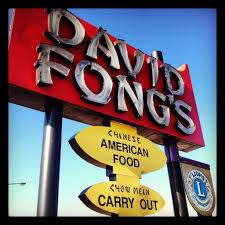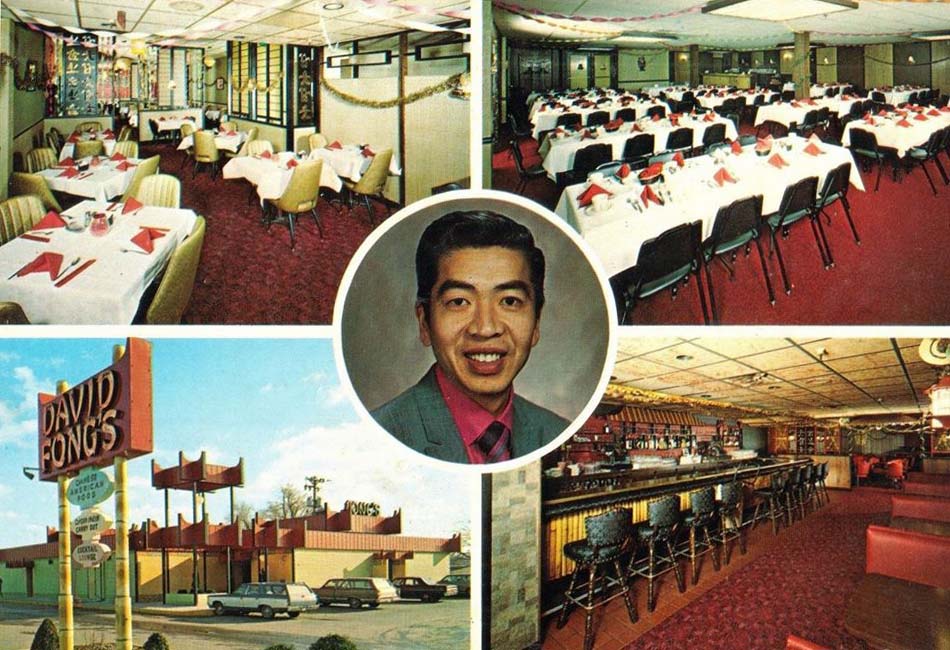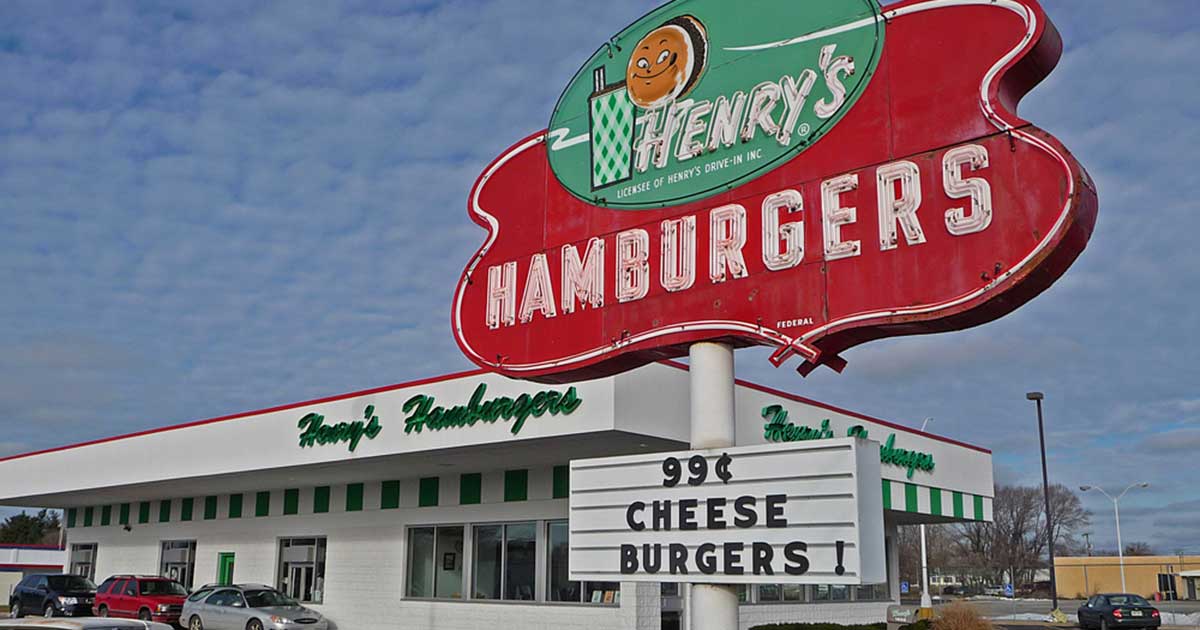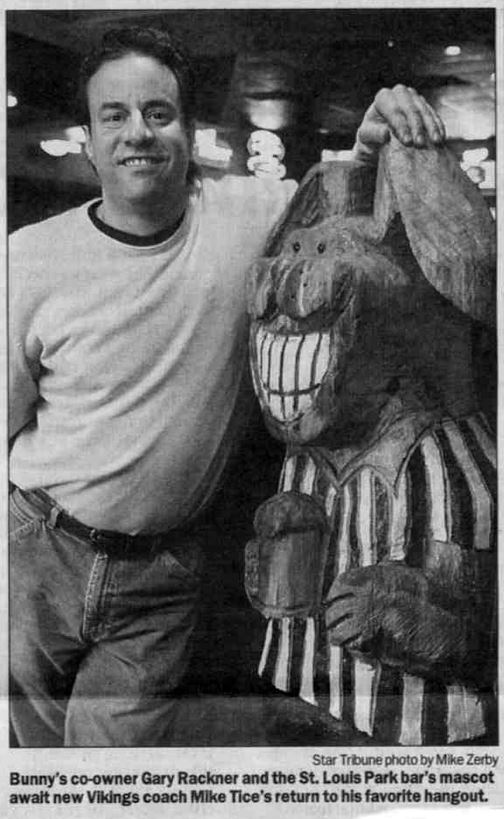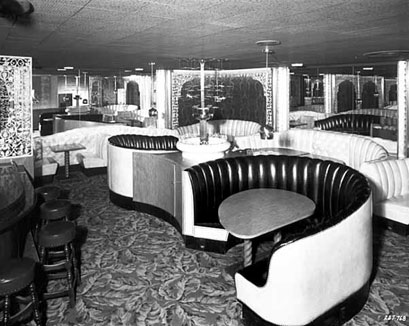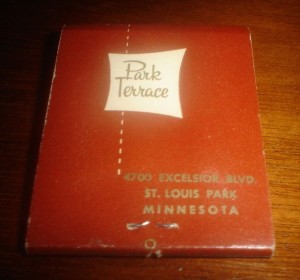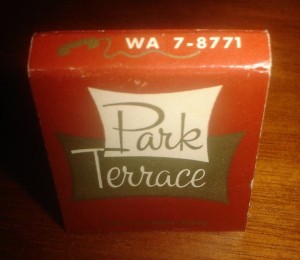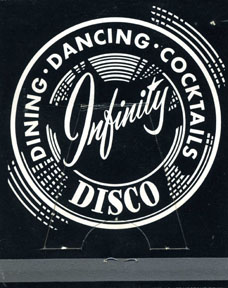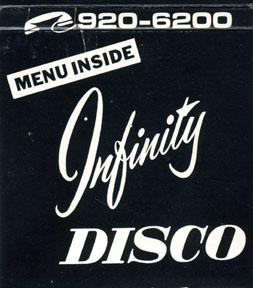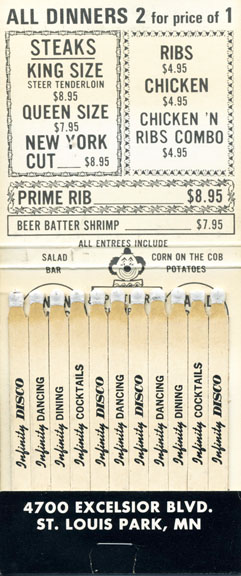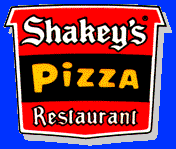Listing the hundreds of live music venues that operated in the Twin Cities from the 19th Century to 1974 may be an impossible task, but it’s great fun! If you have any to add or corrections to make, please contact me. I also appreciate any personal stories!
Listings (below) are mostly in alphabetical order; if there were multiple venues at one location, I’ve put them on one page and they’re listed at the location in chronological order. If you know what you are looking for, you can use the search in the menu bar.
NOTES:
When I cite Stebbins, I am referring to a Ph.D. thesis written by Robert A. Stebbins in 1964 The Jazz Community: The Sociology of a Musical Sub-Culture. See the section on Sources on the Home Page.
Many of these photos and information come from the folks on Facebook. I try to get permission to quote people and give credit on the photos. If I’ve grabbed one of your photos and not given you credit, please let me know!
I have BOXES of additional information and hundreds of additional photos to insert, so watch this space!
Also, hotels are not listed under “H” but under their other name, thus Nicollet Hotel, not Hotel Nicollet.
VERY IMPORTANT:
Shows at these venues are ONLY listed on their Venue page, not on the Events page:
- Depot
- Excelsior Amusement Park/Danceland
- Guthrie Theater
- Eagles Hall/Labor Temple
- Metropolitan Sports Center (“Met Center”)
- Minnesota State Fair
- Someplace Else
Please see Stagecoach Inn.
The 14th Circle was a folk venue at Hamline University.
19 West 15th Street, Minneapolis.
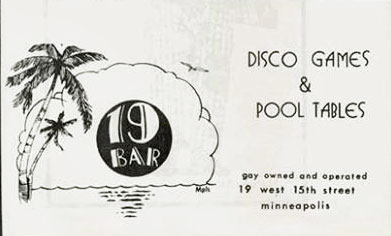
Not sure of the date, but here is an ad
Save
26 Club on Lake Street featured jazz from the Korta Quartet but lost its cabaret license, forcing it to stop live music at 11 pm.
305 Club featured jazz during at least 1961 – 1964.
The 311 Club was located at 311 West Broadway in Minneapolis.
It was a 3.2 bar that featured Country music.
The building dated back to 1887. In 1912, 311 was a saloon.
In 1941 the operator of the bar was Andrew Folta.
It appears from permit records that it became a bar in about 1948.
Sherwin Linton and the Fender Benders played there in 1959.
The Blue Water Boys performed in January 1961.
In March 1963, the operator of the tavern was identified as Mrs. Judith Collins.
In September 1963 the bar was for sale.
In December 1964, the City’s liquor committee threatened to revoke Richard C. Nelson’s 3.2 license because he failed to reveal the true ownership of the bar.
A permit to demolish the building was taken out on May 12, 1971. The dimensions of the building were given as 75 x 75 x 26 (2). Two buildings?
331 – 13th Ave. NE, Minneapolis. I have absolutely no idea about this, but I had this great photo, so here it is! Besides, it was identified as a “Club” from wherever I got it. Feel free to set me straight!
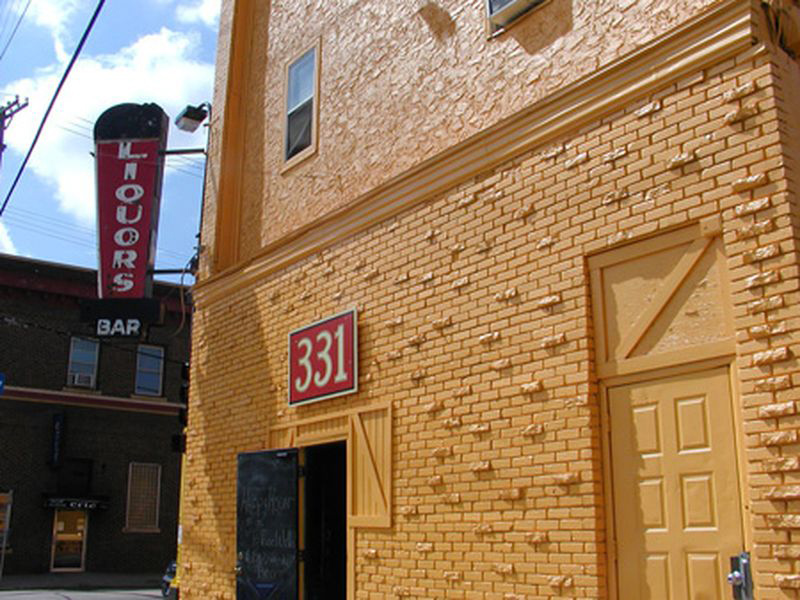
The 4-M Club was advertised in the Minneapolis Spokesman as a “Twin City New Dance Hall” in May 1952. It was located at 150 West 4th Street, across from the St. Paul Auditorium. It was never mentioned again in the Spokesman.
The 49 Club was located at Highway 49 and County Road J at the border of Lino Lakes. The ashtray below says New Brighton, but Ryan Kelzenberg wrote to explain that “At that time the area wasn’t well known and oftentimes the Post Office that covered the area was used as the closest large city.”
The club was founded in 1962, according to documents from 1993, and was considered one of the “doors” into Lino Lakes.
The ashtray below says that the club had live music on Fridays and Saturdays.
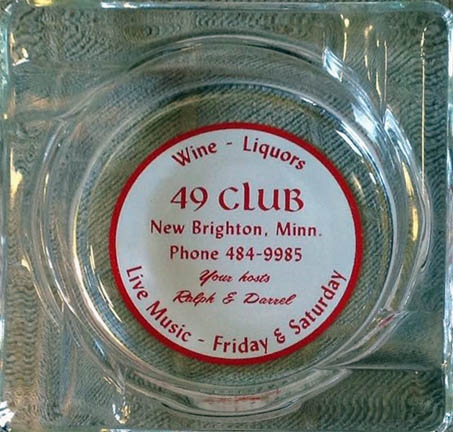
From the collection of Mark Youngblood
A June 1966 article gives the owners as Ralph L. and Anthony Nathe. Ralph Nathe died in Bemidji on November 28, 1992, at the age of 68. In 1993, Dave Nathe petitioned for improvements on behalf of the club.
Below is an ad from a 1969 desk blotter put together and distributed by Pat Richie, late owner of Richie’s Razor Repair.
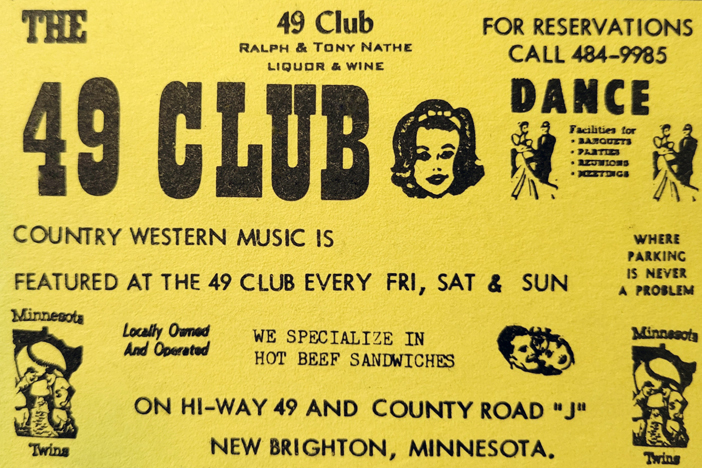
Image courtesy Landon Vath
TROUBLE AT THE 49 CLUB
In December 1989, Brian David Patterson killed a U of M researcher from Nigeria and his three children after having 9 or 10 drinks at the 49 Club and driving drunk. He was offered rides home from friends and from staff at the bar but insisted on driving home himself. He plead guilty and was sentenced to 63 months in prison. The family’s crumpled car was attached to a billboard in St. Paul erected by Mothers Against Drunk Driving. The widow and mother of those killed filed a lawsuit against Patterson and the bar.
1993 UPGRADE
In November 1993, Dave Nathe, on behalf of the 49 Club Bar/Restaurant, requested permission to replace the front wall with 42 feet of glass to provide additional seating and “brighten up the interior, which presently contains no windows.” The proposed upgrade, “while not a complete answer to improving the exterior image of the club, is a substantial improvement over the current facade,” wrote the Lino Lakes Economic Development. The statement of need stated that the interior would be “transformed from a dark and dreary area with no windows into a very bright and open space with over five hundred square feet of glass.”
Highway 49 no longer exists. It originally followed Rice Street from downtown St. Paul into the northern suburbs of the Twin Cities, shifting a northern termini between Interstate 35W and also the Lino Lakes Correctional Facility. In the late 1990s, the route was cut back to end at Interstate 694 in Shoreview and then fully removed shortly after. Guide signs at the County Road 23 exit from Interstate 35W in Lino Lakes were marked as “OLD 49” for five years after the removal; these signs were removed around 2003. (Wikipedia)
THE END OF THE 49
On November 16, 1996, a rainstorm caused water and ice accumulations on the flat roof over the banquet hall of the 49 Club, which damaged the roof and caused flooding in the banquet hall. The Nathe Brothers (owners) claimed that the roof actually collapsed from accumulations of water and ice, but their insurance company contended that the roof merely sagged. The matter was taken to court.
The building was vacant since approximately 2003. It had become a blighted location with illegal dumping and vandalism instances occurring on a regular basis. (Quad City Press, October 2016)
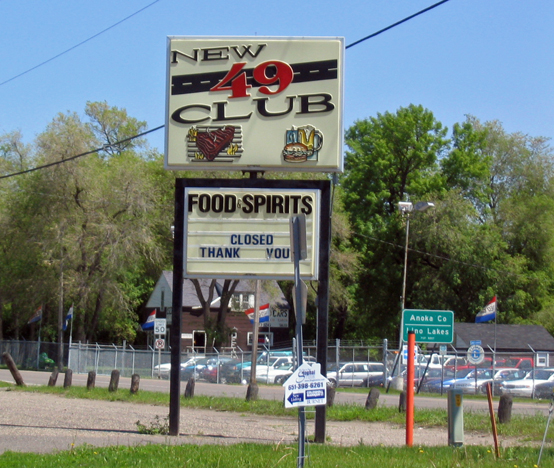
2004 Photo of sign courtesy Tom Lauducci
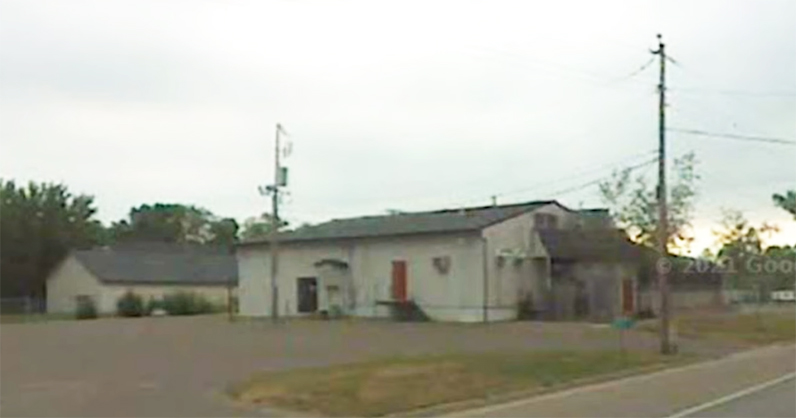
Google Image
The building was deemed “structurally substandard” by the City Council on April 11, 2016. It was demolished in October 2016.
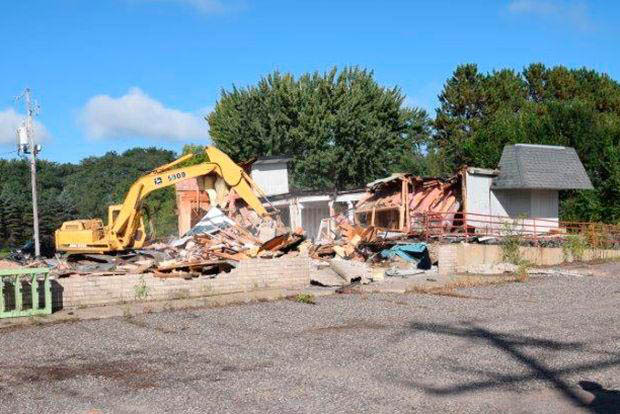
Quad City Press, October 2016
See a memoir of that includes the 49 Club on YouTube.
Thanks to Tom Lauducci for helping with this venue!
The 617 Club is now at 2185 Fourth Street in White Bear. It was named after its former address, 617 Fourth Street; the address was changed in the 1980s.
The bar opened on March 9, 1934 – previously it was Mel Kirkby’s Sweet Shop, which usually meant a speakeasy. Paul Albrecht was the original owner.
After over 30 years Albrecht sold it to Rod Olson, a longtime employee. The bar was remodeled in the mid 1950s, adding stained glass imported from Germany. As traditional, employee Mary Montpetit bought the bar in 2003 from Olson.
The 617 House Band was once a popular draw on Sunday nights, hinting at previous live music.
[Info from White Bear Press, August 6, 2014, Kristine Goodrich, Editor]
See Moby Dick’s.
6311 Club was at 6311 Cedar Ave. So. – “Only Place Past Lake Nokomis on Left Side of Road” in July 1943. Beer and Lunches, Dancing. Amar, Prop.
The 639 Club was located in the Kistler Building on the North Side of Minneapolis. Please see the Kistler Building for more information.
3404 Cedar Ave, Minneapolis, 1958
The Academy of Music was built in 1871 at the corner of Washington and Hennepin Avenues in Minneapolis. It was built by Joseph Hodges.
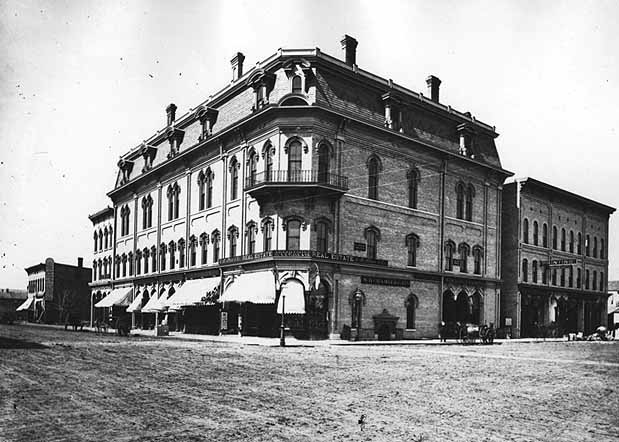
Photo @1874 by William Henry Illingworth courtesy Minnesota Historical Society
The building originally had three stories, and measured 80 feet on the Washington Ave. side and 114 feet on the Hennepin Ave. side. No where did I find an address or an indication as to what corner of the intersection the building was located, although my best guess is the southeast corner. It had a Mansard roof, with terra cotta window caps and galvanized iron cornices. The name of the building was on the Hennepin Ave. side.
The basement held the Central Hall, for use by organizations for parties, balls, banquets, and private functions. The Hall opened in mid-December 1871. It was equipped with a ladies reception room, stove room for cooking refreshments, coat rooms, and restrooms. It measured 110 feet by 40 feet, enough to accommodate 12 sets for dancing. (Minneapolis Daily Tribune, December 6, 1871). The YMCA held its Annual Festival and Oyster Dinner there on December 29, 1871.
The first floor hosted six shops, which had 15 ft. ceilings.
The main stairway to the second floor was on Hennepin Ave.; another was in the alley. The second floor had ten ft. ceilings. The second floor is divided into offices and the ticket office for the Academy of Music.
The Academy of Music was on the third floor of the building. The Minneapolis Daily Tribune described it at length on December 31, 1871:
To be appreciated it must be seen. It is 80 x 85 feet in front of the stage, and is divided into parquette, dress circle and balcony, and will seat about 1,600 persons. The parquette rises 18 inches, and each tier of the dress circle rises four inches, and in the balcony each circle rises nine inches. The parquette and dress circle are provided with upholstered orchestra chairs, and the balcony with reversible seats. The balcony is supported by iron columns, and has an iron rail upholstered in red plush. There are also proscenium boxes, each of which are ornamented with carved work. The extreme height of the building is 39 1/2 feet, and is supported by bolstering trusses framed and secured by rods in such a manner as to be void of any side thrust, leaving only a perpendicular weight upon the walls.
The walls are adorned with a portrait of Beethoven, which occupies a place in the center of the arch, while upon either side are stauettes of Misses Nillson and Kellogg. The dome, ceiling and walls have been frescoed by P. Clansen, and their appearance are really beautiful, and reflect credit on that skillful artist. There are two chandeliers suspended from the ceiling, each having fifty-six lights. The room is therefore brilliantly lighted to the remotest corner.
The stage is 33 feet deep and 78 feet wide with a proscenium arch 35 feet high and 30 wide. The drop curtain is really beautiful. It presents a mountain view as seen from the terrace of a castle. There are also eleven full sets of scenery, with sky and drapery borders, set-woods, water, &c. These are all the work of R.H. Halley, of London, an pupil of the great Telbin, and the equipments are equal to any theatre in the country.
The carpentering was done by David Pratt, who has been conneccted with McVicker’s theatre in Chicago for years, and has fitted this stage with all the appliances necessary to the production of any play. Above and on either side of the stage are six dressing rooms, all conveniently arranged.
Interestingly, the article makes much of the efforts to make the building fireproof.
The Academy of Music was dedicated on January 2, 1872.
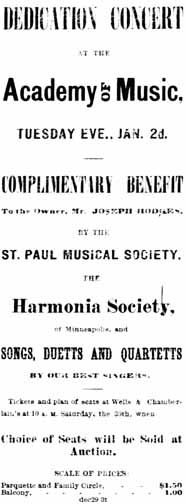
December 29, 1871, Minneapolis Daily Tribune
Early musicians and conductors were A.M. Shuey and pianist Ludwig Harmsen. The latter came to Minneapolis in 1868 and continued active in musical circles until his death in 1915. (Minneapolis Tribune, August 28, 1949)
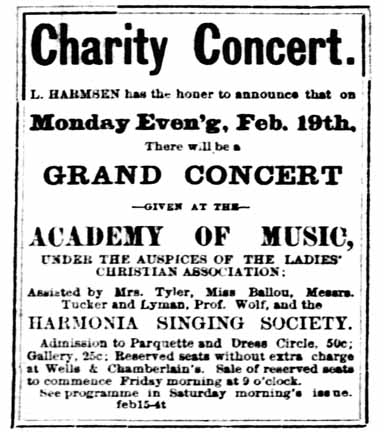
February 18, 1872 – Minneapolis Daily Tribune
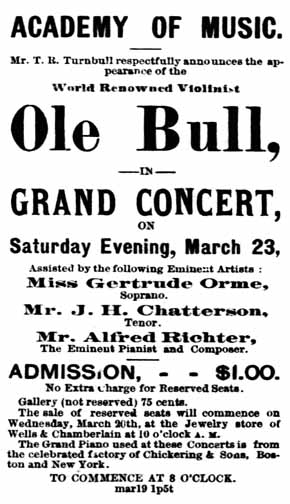
March 19, 1872 – Minneapolis Tribune
On May 1, 1873, Thomas Lowry and the Herrick Brothers purchased the building. Lowry sold his interest in 1875 to Dorillus Morrison.
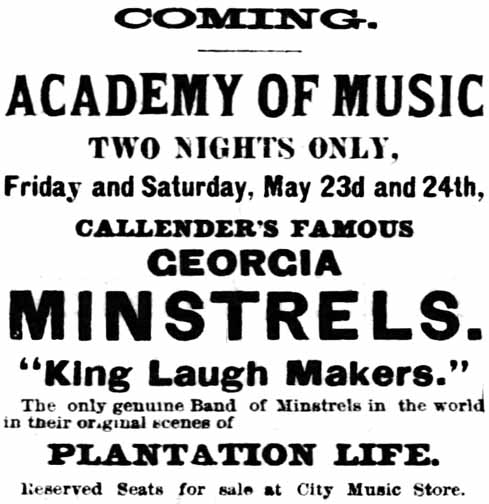
May 17, 1873, Minneapolis Daily Tribune
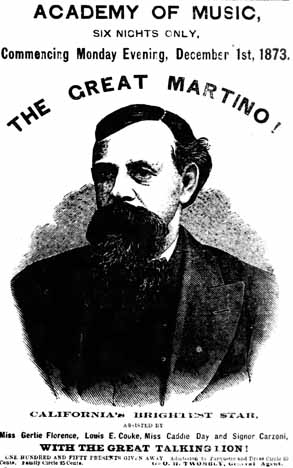
December 2, 1873 – Minneapolis Daily Tribune
The Herrick Brothers redecorated and added new scenery and dressing rooms in 1876. At that time the building was deemed to be unsafe if a fire were to break out, so a third egress stairway was added.
An article in the Daily Minnesota Tribune (January 1, 1883) indicated that the Academy had “outgrown its usefulness” and that a portion of the Syndicate Block was being made into an Opera House to replace it, to be ready in the middle of February 1883.
On March 24, 1883, the Daily Minnesota Tribune reported that the Academy of Music would soon be reconstructed into a handsome business block, six stories high.
It is clear that the new Opera House replaced the Academy of Music, as the sale of tickets to the Grand Opening of the Grand Opera House was conducted at the Academy in March 1883.
The last performance at the Academy was the comic opera “The Electric Spark” by Atkinson’s Jollities on March 28 and 29, 1883.
On March 30, 1883, the Daily Minnesota Tribune gave this eulogy:
The curtain was rung down for the last time at the Academy of Music last evening, and this well known place of amusement will soon be transformed into a business block in which green rooms, supes, and transformation scenes will be known no more. The building has served its day and generation well; and though the onward course of events has pushed it aside and it is no longer equal to the demands made upon it, but must give place to a newer, better and more pretentious rival, it will always be remembered by those who have been amused or instructed within its walls with gratitude and pleasure. The company that had the honor of closing its career as a place of amusement was Atkinson’s Jollities. Soon bricklayers and carpenters will so transform it that it will be speedily forgotten by the throngs of amusement seekers, but nevertheless many will remember the good times spent in the Academy of Music long after all trace of it has been obliterated by the onward march of the city.
An ad by Big Boston, a clothing store in the building, announced a sale necessitated by the pending demolition of the building by July 1, 1883, and the erection of an 8-story block (large building) in its stead. (Daily Minnesota Tribune, May 1, 1883). It didn’t happen, and Big Boston was still in the building to the end.
Instead of being totally demolished, the building was gutted, enlarged from three stories to five, and turned into an office building in 1883. Only the outer walls of the original building were used. The reconstructed building was ready for occupancy on November 1, 1883. Indications are that the building continued to be known as the Academy of Music Block
THE GREAT ACADEMY OF MUSIC BLOCK FIRE
The building burned to the ground on December 25, 1884. Several factors made this fire almost impossible to put out: (Minneapolis Tribune, December 26, 1884)
- The call was put in at about 3:30 pm; as it was a holiday, the building was virtually vacant, but at the same time, it was difficult to find firemen.
- The temperature – 15 below during the day, 30 below by midnight – put the firemen in danger, turned the water to hail, burst a hose, and turned the street into a skating rink.
- From newspaper reports, it doesn’t sound like the source of the fire was ever found. A Tribune reporter was on the scene almost immediately, and entered the building to investigate, but smoke pushed him out quickly. A fireman made it to the fifth floor, where he got trapped and for some tense moments until a ladder finally made it to him and he was rescued.
- The building was deemed “a fire trap” more than once in the article and no one wanted to risk life and limb to go in.
- Individual gas meters were exploding, adding to the danger.
- The building had a glass skylight and a saloon with a large plate glass window; all of the windows eventually burst from the heat of the fire or the effects of the water/ice.
The Minneapolis Tribune reported that “The crowd seemed to be having an extraordinarily good time.” In other words, there was some looting going on, especially at E.H. Steele’s Boston One-Price Clothing Store. One man was caught wearing three coats and was thrown in the clink.
The report hints that the fire started in a back elevator shaft, but it is not an official report from the fire department.
THE LAW LIBRARY
The Minneapolis Bar Association’s law book collection was lost as well.
Nearly two years ago Thomas Lowry kindly donated his splendid collection of almost 1,800 volumes to the lawyers of Minneapolis, and they immediately formed a library association. The collection has been continually added to until there were upward to 5,500 volumes in the library. The value of the collection is placed at $18,000. ($15,000 was insured.)
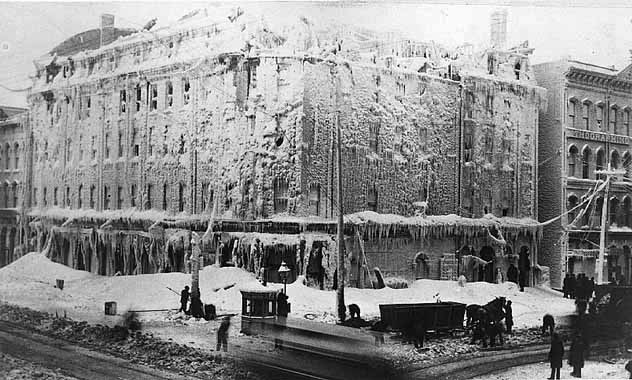
December 25, 1884 – photo courtesy Minnesota Historical Society
Demolition of the building began in March 1885. The Temple Court business block was constructed in its place. A look at the current map shows three of the four quadrants of the intersections as vacant land, and the fourth as a building built in 1964.
The Ace Box Bar had two locations, both in St. Paul.
2360 UNIVERSITY AVE.
2360 University Ave. (at Raymond) is the Specialty Building, named for the Specialty Manufacturing Company. The space that was the company’s lunchroom in the 1930s became the Ace Box Bar and Cafe.
The photo below shows that the bar had a bandstand – at this point hosting the Arions, “America’s Only Blind Road Orchestra.”
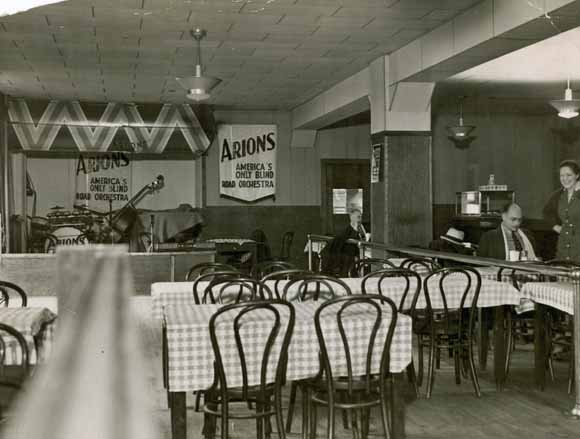
1937 Photo courtesy Minnesota Historical Society
In 1937 the bar was owned by Edward H. Sharretts, a boxing promoter who was profiled in the Minneapolis Star on November 6 of that year.
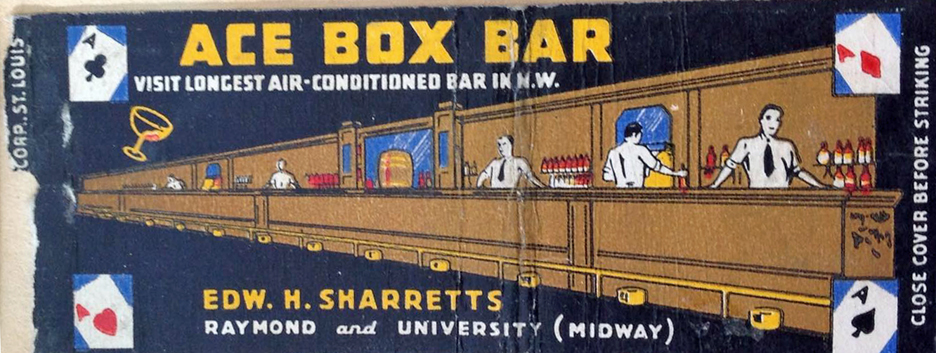
Image posted by Marshall Zechlan
The Ace Box was at this location at least through September 1941, when a robbery occurred.
Caffe Biaggio has been in this location since 2002.
2162 UNIVERSITY AVE.
2162 University (at Vandalia) had previously been Cozy Lunch.
The Ace Box relocated here sometime between September 1941 and the end of February 1945.
The photo below from the Minnesota Historical Society is labeled with the 2162 address and is dated 1940, which cannot be. Note the Hillbilly band, a popular genre at the time.
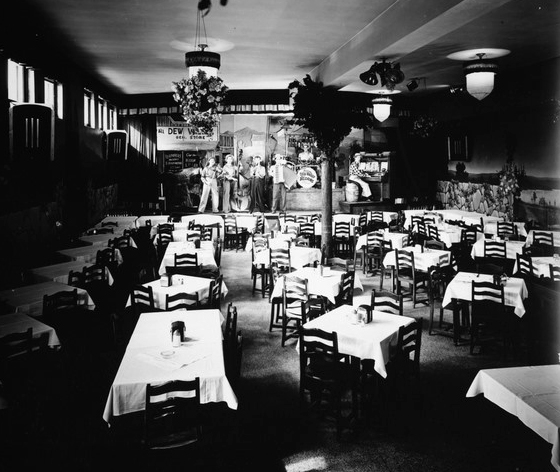
Photo courtesy Minnesota Historical Society
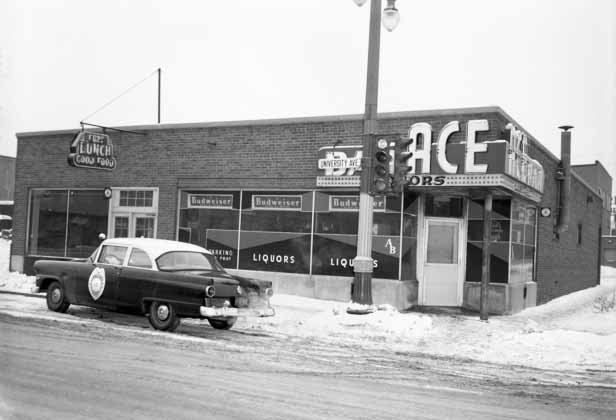
1956 Photo Courtesy Minnesota Historical Society
The Ace Box became the Dubliner in 1996.
St. Paul – jazz venue
Addison’s Bar was located at 1504 E. Franklin Ave. in Minneapolis.
ADDISON’S BAR AND LOUNGE
I found this matchbook online, and had no idea if it was a music venue or not, but I figured maybe the word “lounge” implied a lounge singer?
A peek into the Minneapolis Star and Tribune archives shows that this was a mobbed-up bar owned and managed by various members of Kid Cann’s family, and I’m glad there was no music involved so I don’t have to go through it all! The first hit was in 1937, and the last was in 1988, when it was known as Addison’s Bar a/k/a The Bear’s Den. It was demolished in about 1988.
I put the question about whether there was any live music on this page, and got lots of answers! This, my friends, is why this is not a book – the information keeps rolling in!
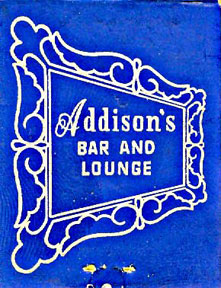
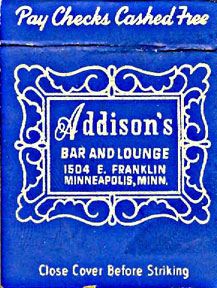
GARY BUSH
The first person heard from was Gary Bush, who wrote:
JIM SCHAEFER
Then I got this great email from Jim Schaefer about the Bear’s Den:
Two adjacent buildings I shot along East Franklin I remember well, but the negatives show no address, which I would like to know. Current Google street view shows they have both been replaced with new construction, so I googled the business names. One was a tiny “lounge” bar, the kind that has (or used to have?) only one window and that was curtained. The signs in the parking lots on either side identify it as the “Bear’s Den.” That is the name I googled; it shows up in only one response to my query, where it is identified as “Addison’s Bar / Bear’s Den” at 1504 East Franklin. That’s it where your matchbook came from. I haven’t worked on this negative yet, but I’ve attached a quick-and-dirty thumbnail image of it.
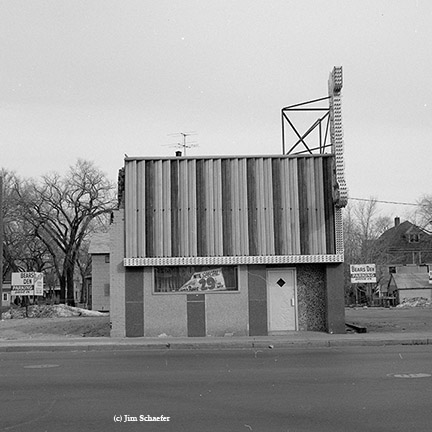
Bear’s Den, February 1976. Image courtesy Jim Schaefer
Jim’s quick and dirty image is the perfect size for me! Thanks, Jim!
CINDY BLUMER
Cindy wrote to say:
Adolph’s Bar was located at 4151 West Broadway in Robbinsdale. (There was another Adolph’s Bar at 408 Cedar Ave. in Minneapolis in 1934.)
The first we see of Adolph’s Bar in the Twin Cities papers is in the Minneapolis Star Journal on October 13, 1939, when it is listed in the bowling scores.
Flo Ann (Jullie) Tauber’s husband Adolph opened the bar, and at some point he was Robbinsdale’s Fire Chief. But Flo was probably running the place by 1950. She also owned Jullie’s Menswear and wrote “Flo’s Chatter” in the North Hennepin Post.
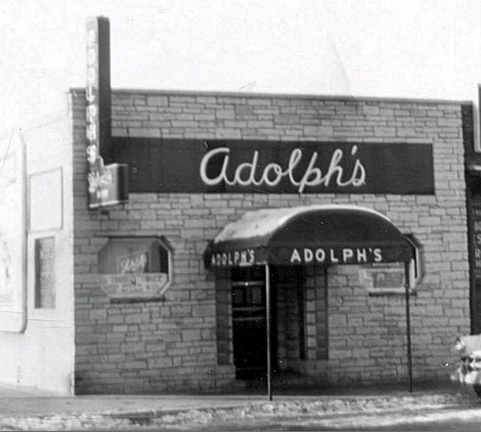
1950 Photo courtesy Robbinsdale Historical Society
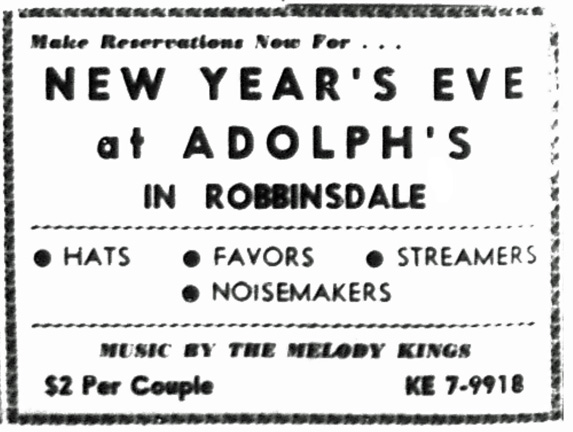
North Hennepin Post, December 31, 1957
Adolph’s was a popular destination for underage drinking, dining, and dancing – Sherwin Linton performed there in 1962. So did Conway Twitty? One patron remembers that they had a twist contest there every week in about 1965 or ’65.
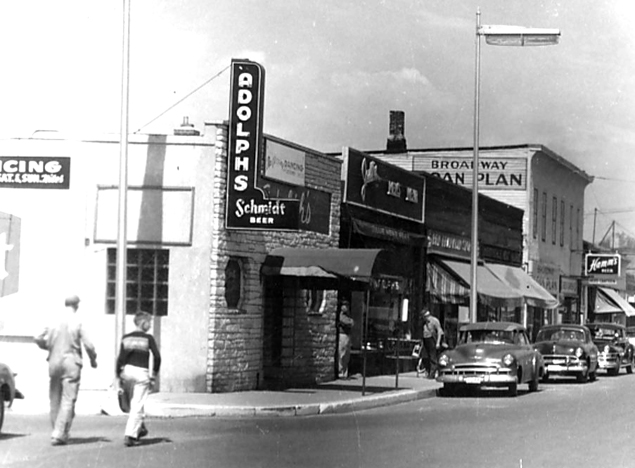
Photo courtesy Robbinsdale Historical Society
One source lists it as a jazz venue.
In June 1964 the owner of the bar was James Zaccardi.
In September 1965 the new owner was apparently someone named Marxen, who advertised for two waitresses and two bar maids who doubled as go-go girls.
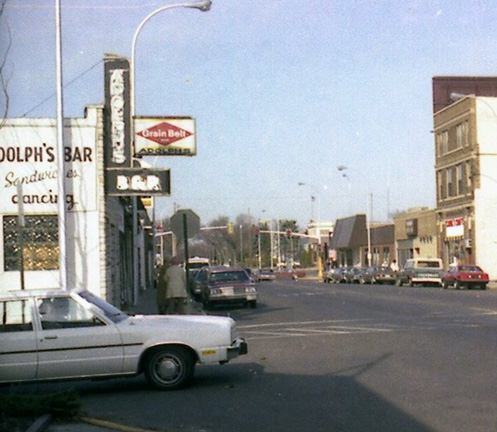
1980 Photo courtesy Robbinsdale Historical Society
On September 10 and 11, 1988, the bar was advertised for sale in the Star Tribune.
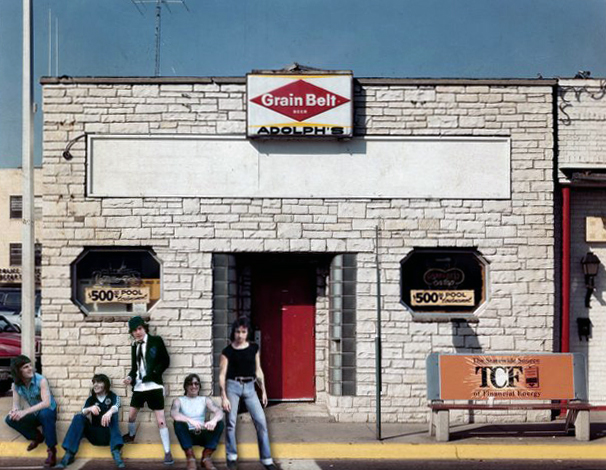
Courtesy Robbinsdale Historical Society
The Robbinsdale Historical Society reports that the bar burned down on September 15, 1988.
The Air-O-Inn had two locations.
6600 34th Ave. So.
The original location was in Richfield. Greg Rohlen wrote that it was a staple for those working at the airport and for folks flying out of the airport. This location would be on a taxiway at the airport today.
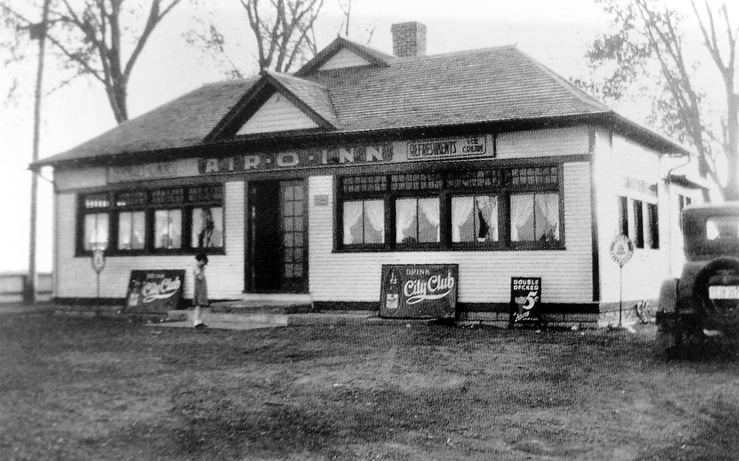
The original Air-O-Inn
The Air-O-Inn was around by at least October 1933, and was probably one of many post-Prohibition taverns that popped up all over the place after 3.2 beer became “non-intoxicating” as of April 7, 1933. Here’s the earliest ad I found:
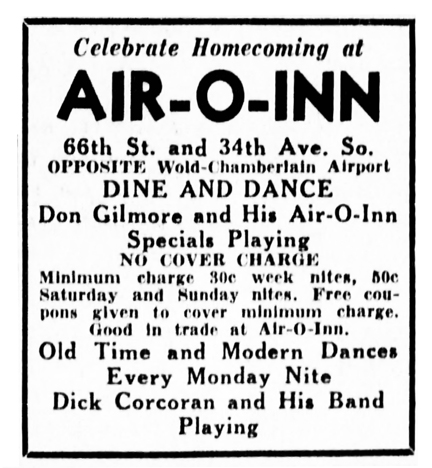
Minneapolis Star, October 28, 1933
Jack Hohag was the proprietor in 1942. An all-girl band presided at the bandstand during this War year, and stuck with Jack despite offers from Chicago to thank him for taking them in during their lean years. (Minneapolis Star Journal, July 12, 1942)
2731 E. 78th STREET
As the airport grew, the building was moved to Bloomington, on the present 494.
The Bloomington News reported that the Air-O-Inn would reopen for its regular dancing, refreshments, and fine food at its new location during the week of October 12, 1950. The new owners were Ted Terp and Tony Gerkowicz. The newspaper reported:
The building looks just as it used to when it adorned the corner of 66th and 34th avenue south, only that it is turned around now, facing north. A full basement has been provided and equipped for private parties. The surrounding spacious parking space has been blacktopped and the front of the Inn beautifully landscaped with cedars, spruce and pines.
The owners will feature their regular dance parties and promise first class orchestra music every night.
Everett McClay VFW Post 1296 bought the Air-O-Inn and took possession of it on October 15, 1951. It announced its intention to hold old time dances on Thursdays and modern dances on “Friday, Saturday, or Sunday night.” Jack Hohag would appear on Thursday nights. It would also start up Bingo, a popular game at its former location on Lyndale and 79th Street (which became the Ranch House). (Bloomington News, October 11, 1951)
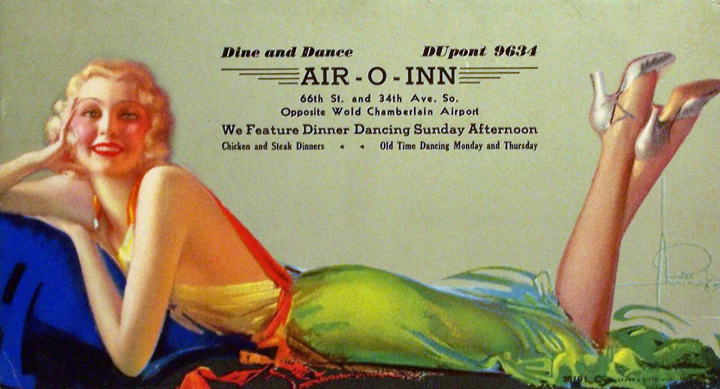
Image posted on Facebook by Dale Westdahl
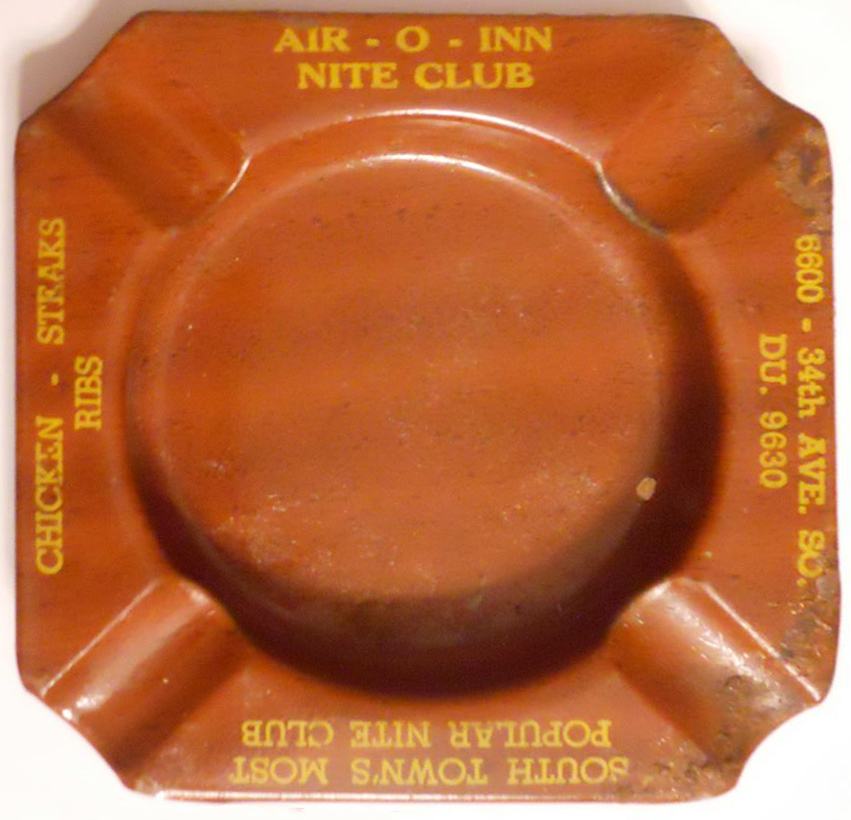
From the collection of Mark Youngblood
Please see New York Public Library.
This legendary St. Paul bar was located in at least three places in St. Paul. The following is pieced together and any help is appreciated to correct or clarify the information.
Alary’s shows up early and often in the St. Paul Musician, the newsletter of the St. Paul Musicians’ Union, which helps to indicate that music was present! Let’s abbreviate this as The Musician.
From the bar’s present website:
Every legend has to start someplace. Ours begins with Al Baisi who played for the Chicago Bears in the 1940s. He was a tough, uncompromising SOB. And we have no idea what the people who didn’t like him thought.
Baisi and many of his teammates went into the service during World War II. He returned to football after the war and was released from the Philadelphia Eagles in 1947.
HEINIE’S
It’s starting to look like Baisi (with or without partner Lawrence Lehner) started his publican career as the proprietor of Heinie’s Club Bar, located at 347 University Ave. (at Virginia) in St. Paul. Heinie’s is mentioned in 1948 in The Musician, and in or by 1950 Heinie’s had become the New Trocodero.
444 WABASHA
In 1949, Heinie’s took over the Drum Bar. This prime downtown St. Paul location, next to the Strand Theater, had many tenants during the years:
- Fadden’s Restaurant, 1911
- Bubbie’s Cafe, 1928
- Zephyr Cafe, 1938 – 1941. In February 1941, the Zephyr advertised for Entertainers, dancers, singers, m.c.’s, novelty acts, burlesque skits, exhibitionists, etc.
- The Drum Stage Bar
In November 1949 the Drum got in trouble for staging a female impersonator show, which probably put them out of business.
The Drum had become “Heinie’s new spot” at least by May 1950, according to The Musician.
Although the Alary’s website says that they immediately renamed it the Alary’s Club Bar, combining the names Al and Larry, news reports are confusing.
In February 1952, Al and Larry were in trouble selling liquor to three teenagers on New Years’ Eve, 1951, at their bar called Heinie’s at 444 Wabasha. The pair also owned a bar called Ship Ahoy at 18 East 8th Street in St. Paul. (Minneapolis Tribune, February 20 and 26, 1952)
[Complicating the matter even further is that there was another Heinie’s at 2601 26th Ave. So. (the future Duffy’s), as cited in May 1950. That other Heinie’s was put up for sale in August 1952 and sold in about February 1953. (Heinie was a popular word back then, used to describe both a buzz haircut and a nickname for a man sporting one.) ]
So sometime between 1952 and October 1954, Al and Larry changed the name of their bar at 444 Wabasha from Heinie’s to Alary’s. On the latter date, The Musician was still referred to as “Alary’s (Heinie’s),” perhaps indicating that the name change was fairly recent.
From November 1954 to April 1959, Augie Garcia was a frequent entertainer.
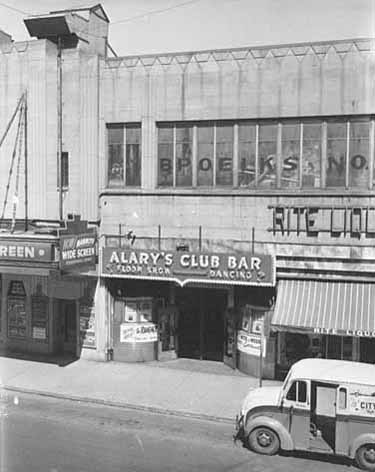
444-446 Wabasha, May 6, 1956. Photo courtesy Minnesota Historical Society
Fire destroyed Alary’s at 444 Wabasha on August 24, 1956. The Strand Theater, on the right, and the Tower Theater (not shown) on the left, suffered smoke damage.
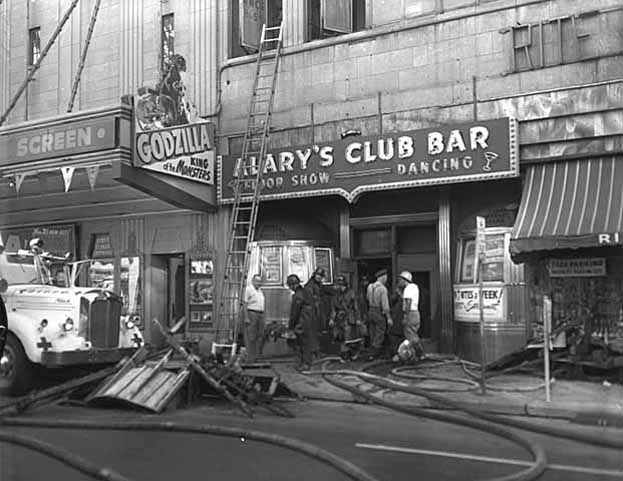
Minnesota Historical Society
457 WABASHA
This was the former location of the Flame Jazz Bar. The Flame had been closed by the end of 1955, so it’s possible that Alary’s moved right in.
Augie Garcia continue to entertain at this location until about October 1959.
In February 1970, Baisi was hit by two shotgun blasts after he had taken a waitress home at 2 in the morning. He may have lost significant sight in one or both of his eyes.
In January 1977, Jon Bream described Alary’s as a decades-old strip club. He gave it a similar review in 1979.
An article in December 1998 noted that the bar closed in 1985; urban renewal was coming to St. Paul, and with the World Trade Center going up across the street, Mayor Latimer made it clear that the now-seedy bar wouldn’t fit into the new scheme of things.
WEST 7th STREET
After moving off of Wabasha, it became a neighborhood bar – sans the strippers – on 7th Street, for ten years.
139 EAST 7TH STREET
Al Baisi and his son, Al, Jr., wanted to return to downtown St. Paul, and in December 1998 they opened yet another iteration Alary’s, which they hoped to be the hub for local Bears fans. The elder Baisi, now 81 and blind, had a special place near the back of the bar where he never tired of telling of his glory days as a football player for the Bears. (Star Tribune, November 23, 1998)
Al, Sr. died on April 15, 2005.
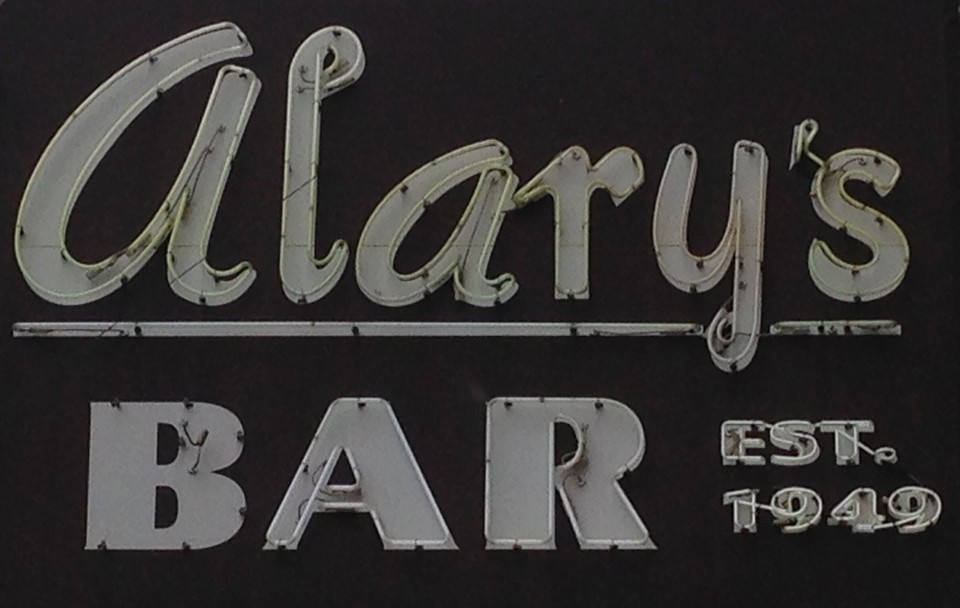
Albert’s Supperclub was located at 6th and Cedar Streets in St. Paul.
It is listed as a new downtown nightclub in a 1973 article in the Minneapolis Tribune (December 3, 1973).
A note says that “an entertainer sings and plays the piano much in the style of Johnny Mathis, Tuesday through Saturday nights.”
The Alcan Club was located at 3700 West Broadway in Robbinsdale.
DE MERS BROS. SALOON
Treffle “Truffy” De Mers and his brother George, French Canadians by birth, operated the DeMers Bros. Saloon at this location in 1903, and probably until 1920. As often happened, when Prohibition became the law of the land in 1920, the building became a “confectionery,” which was sometimes shorthand for a speakeasy. The 1920 and 1930 Census both listed it a confectionery. (In 1930 George was working at a laundry.) When Prohibition ended, Truffy apparently either added liquor to his inventory, or turned his establishment into a tavern and liquor store.
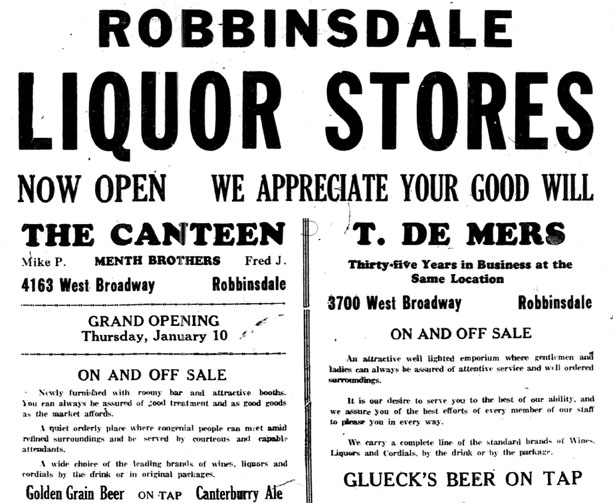
Hennepin County Enterprise (Robbinsdale), January 3, 1935
ALCAN CLUB
In 1942, the business was purchased by Joe DuPere and Art Bolier, two Army veterans who had been part of a group of Robbinsdale men who had worked on the Al-Can (Alaska-Canada) Highway.
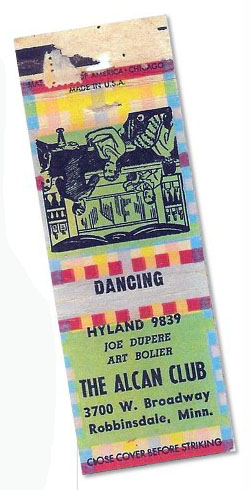
Courtesy Robbinsdale Historical Society
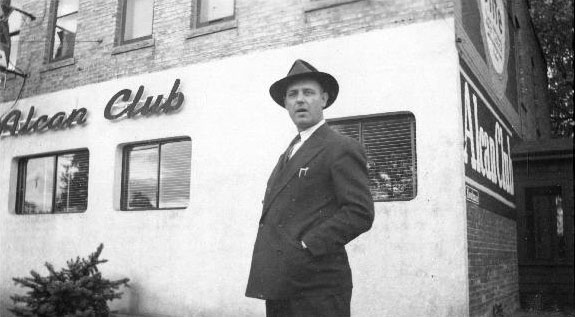
Art Bolier at the Alcan; Photo Courtesy Robbinsdale Historical Society
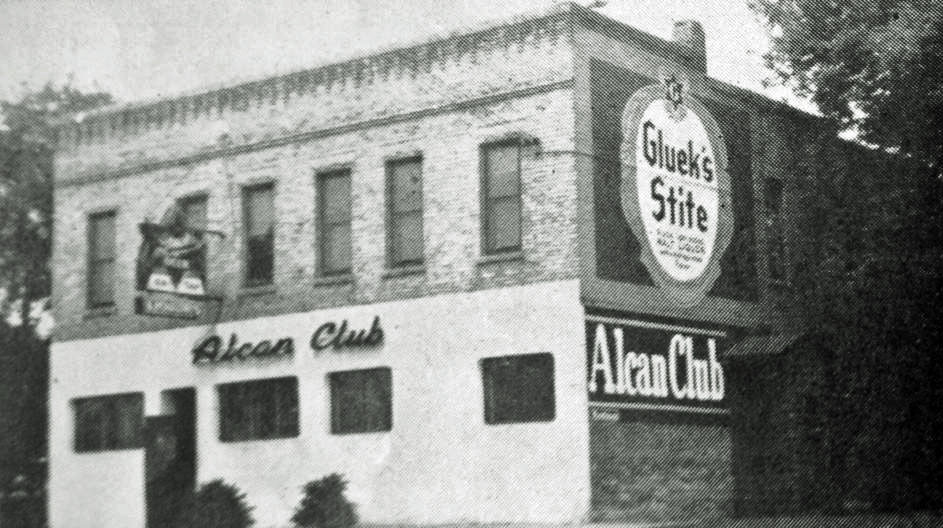
Photo Courtesy Robbinsdale Historical Society
SHERRITT’S TAVERN
For three years, from about 1955 to 1958, the tavern was owned by Moose Sherritt, who changed the name to (natch..) Moose Sherritt’s Tavern.
THE NEW ALCAN
In 1958, Sherritt went into “private business” and sold it to John Pappas. John was previously in partnership with his brother George as owners of the Club 26 at Hennepin Ave. and 26th Ave. So. The North Hennepin Post reported that as of April 10, 1958, the name would become the “New Alcan.” John Pappas said that he planned to remodel the building, adding a false ceiling, new floor, and aair conditioning. He also planned to remodel the upstairs hall, which was rented for community events.
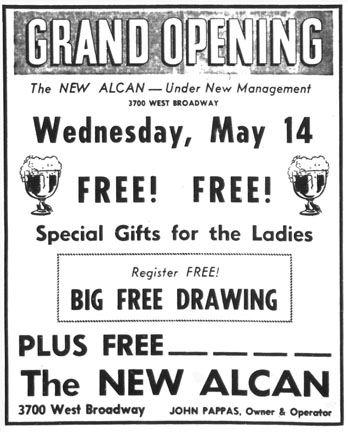
1958, North Hennepin Post
According to the Robbinsdale Historical Society, the building was torn down in the late 1950s. The empty lot near the corner of 36th ad West Broadway was a used as a mini golf course until 1964 when Guaranty Bank opened on the corner.
This venue was located at Marquette and Sixth Street South.
Edgar wrote that during the summer of 1885, the first stock company presenting light opera in the city was seen there.
Aldrich Arena was primarily an ice skating/hockey venue, located at 1850 White Bear Ave. in Maplewood, described in 1964 as “St. Paul’s East Side.” Built in 1962, the arena was named for the late Gene Aldrich, who pioneered the Minnesota State High School Hockey Tournament in 1944.
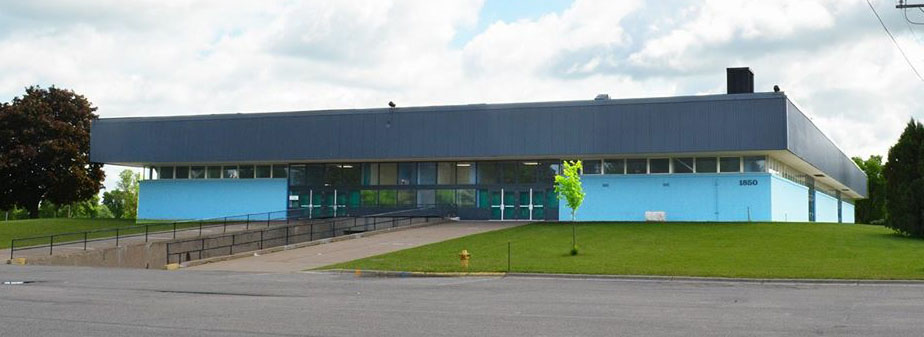
There were occasional concerts there but I didn’t find many. Most were big events hosted by radio stations.
1964
On June 5, 1964, KDWB presented The School’s End “Battle of the Bands in the Round!” with:
- Gregory Dee and the Avanties
- The Jades
- The Lancers
- The Mystics
- The Wanderers
On July 14, 1964, KDWB sponsored a “Super Colossal Midsummer Hop!” aka “Battle of the Bands in the Round” at Aldrich Arena. Appearing were:
- The Underbeats
- Keith Zeller and the Starliners
- The More-Tishans
- The Tremadons
- The Sting-Rays
1965
Larry O’Connell says the best Battle of the Bands took place at Aldrich Arena during the summer of ’65: noon to midnight!
1966
SCHOOL’S OUT SPECTACULAR
June 10, 1966, was the fifth annual “School’s Out Spectacular” at Aldrich Arena in St. Paul, sponsored by KDWB. Over 5,000 kids attended the event, dancing to eight bands, including the Ides of March and Dee Jay and the Runaways. Funds raised went to the Ramsey County Jr. Sheriff”s Patrol for rain coats, hats, and safety signs.
Here’s a photo of the Summer 1966 Battle of the Bands, featuring the He Too’s. (Thank you, Debra Deutsch Erickson!)
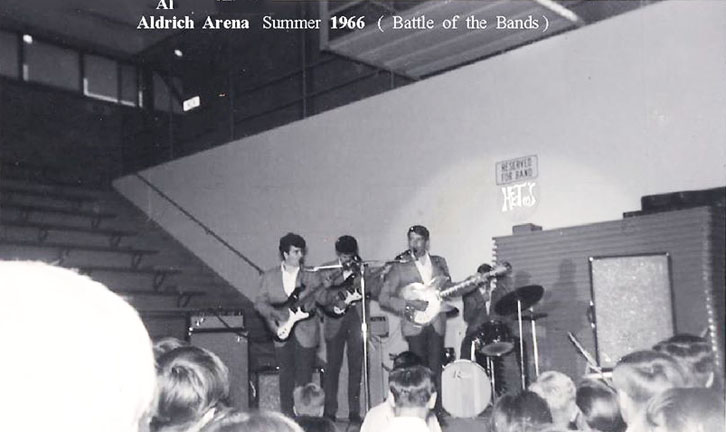
Courtesy minniepaulmusic.com
1967
PSYCHEDELIC SOUNDBURST
On May 7, 1967, the “Psychedelic Soundburst” (or Sound-Burst) took place at Aldrich Arena. The show, emcee’ed by KDWB’s Charlee Brown and Earl L. Trout III, was billed as the “Biggest Dance in the History of Aldrich Arena” and promised the world’s best light show – the Fillmore Light Show. The Music Scene reported that the show was presented by Rich Hanson, who planned another for June called “School’s Out – Book Burning Blast.” (did this happen?)
Featured performers were:
- The Del Counts
- The Hot Half Dozen
- Danny’s Reasons
- The Litter – “a group that equals The Electric Prunes in sight and sound”
- Grasshoppers – Headliners
- Happy Dayz(e?)
- Youngsters
- Sir Raleighs
- The Chancellors, just home from triumphant tour of Kansas
- Dozen
- The High Spirits
JULY 4, 1967
Nick Tschida described a big, 12-band show at the Aldrich Arena on July 4, 1967, that went from noon til midnight, sponsored by B Sharp Music Store. Bands participating included:
Aesop’s Phaebles, Nick’s band, which led off at noon. Nick remembered there being 1,500 kids there, even at the beginning of the show at noon!
- Metropolitan Soul
- Grasshoppers
- Del Counts
[7 more bands]
- USAs
Nick says, “Fun Gig ! Jimmy Lopez had the stage all set up with B Sharp’s equipment….Had a great time!”
BACK TO SCHOOL
In August 1967 the Fillmore Light Show came to Aldrich Arena, with six top bands (unnamed in the ad). This may have been this:
On August 21, 1967, a 12-hour Back to School dance was held at the Aldrich Arena, featuring the following local bands: (Thanks to who ever posted this poster on Facebook!)
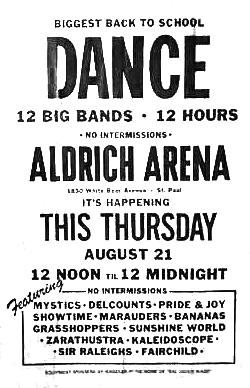
- The Mystics
- The Del Counts
- Pride & Joy
- Showtime
- The Marauders
- The Bananas
- The Grasshoppers
- Sunshine World
- Zarathustra
- Kaleidoscope
- The Sir Raleighs
- Fairchild
1972
Gypsy played a benefit concert on May 10, 1972. Profits were to go to Anicom, a Minneapolis-based sound company whose technicians were involved in a serious truck accident several weeks before. Also performing were:
- Copperhead
- Pepper Fog
- Valdons
The venue continues to be used primarily for hockey and graduation ceremonies.
Please see the Excuse Club. (Get it?)
Alkali Ike’s Eatery and Saloon was on Highway 101 just north of the 7-Hi Shopping Center in Minnetonka. In July 1973, Jody and the Jonquils performed nightly in the Saloon: “Their original dance routines and their variety of pop tunes, country western music and show tunes have entertained thousands of audiences.” Another ad was for Delores Del-Rae and Her Vitamin E Trio – I’ll bet that was a fun act!
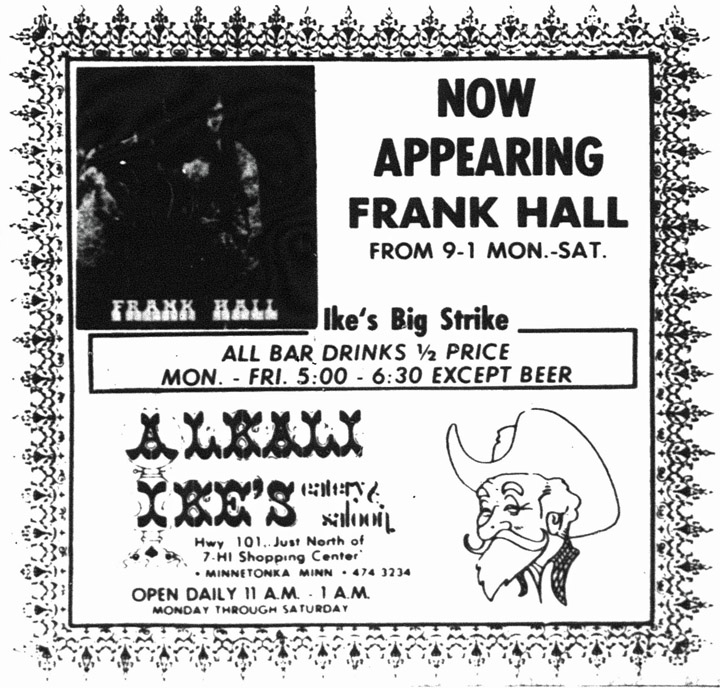
Ad dated February 28, 1974
The Club Alla Bar was located in White Bear Lake.
It was run by Alfred J. LaBarre, and was extant by at least April 1941. I thought I’d be clever and look for Al in Ancestry.com, but honest to goodness, there are two Alfred J. LaBarres from St. Paul, one born in 1899 and one born in 1900. Dang!
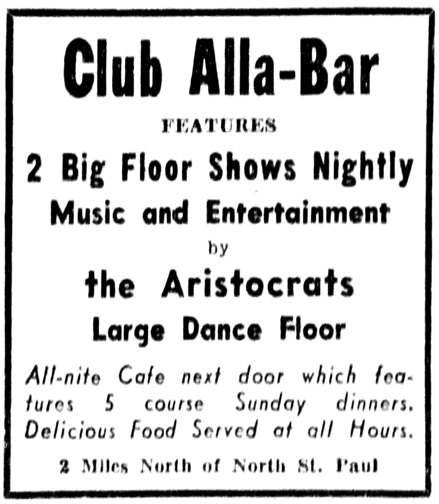
Minneapolis Star, June 6, 1942
The directions in the ad below are complicated: two miles east of Hoffmann’s Corners on County Road E and East County Line, or two miles north of North St. Paul on East County Line.
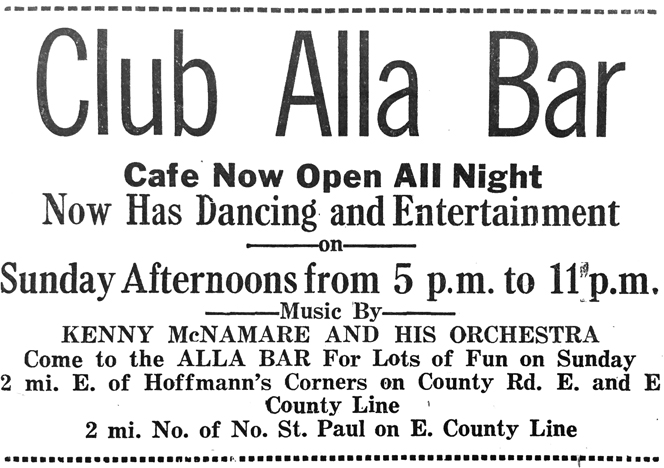
White Bear Press, June 29, 1945, courtesy White Bear Lake Historical Society
We learn more from the folks on Facebook:
- “There used to be a dirt road loop probably less than a quarter mile north from the intersection of East County Line and County Road E. My dad told me when I was a kid that this was Alla Bar Lane.”
- “I remember the shopping center at 244/County Road E and East County Line Road.” Indeed there was an Alla-Bar Shopping Center in 1962 and 1963; in 1962 it included Wayne’s Department Store.
- “East County Line is the same as 120. Hoffman’s Corners is still on the corner of Highway 61 and County Road E.”
- “Soft wooden dance floor which bowed with too much weight on it. Illegal speakeasy. Washington County Sheriff chased LaBarre when he was smuggling in kegs; LaBarre had a huge engine in his truck and left him in the dust.”
St. Paul – jazz venue
The Aloha Club Ballroom was on Highway 13, 2 miles west of Prior Lake in 1954. Dance by Moonlight – comfortably heated – on Beautiful Spring Lake. No age limit. Percy Hughes, Judy, and Dickie Mayes performed Fridays and Saturdays in April.
The Alps was located at 801 E.78th Street in Bloomington. It opened in May 1966.
The A-frame building had three levels and was frequented by stewardesses, pilots, and other airline folks due to its proximity to the airport.
In July 1966, Will Jones reported that when it opened there was a Dixieland band and the plan was to have some Dixie, some rock, some “banjo singalong.” After a few weeks, though, It became all rock. Jones’ description of the place was pretty visceral:
It’s easy to understand why, after a recent look-in on a Saturday night. the place was throbbing with an immense, almost frightening, youthful vitality, aided and abetted by an acoustical quirk that in most places would be considered a problem but in this hall has almost become a virtue as it magnifies the din to unbelievable proportions.
At the time the house band was Danny’s Reasons, and Jones had (I think) good things to say about him:
Stevens is not a mere performer, but a writhing star among writhing stars. I’d recommend a visit before somebody grabs him and signs him for a lifetime of beach-party movies.
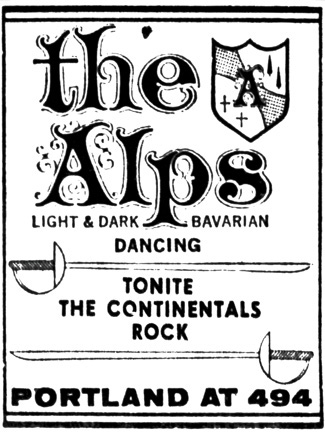
August 19, 1966
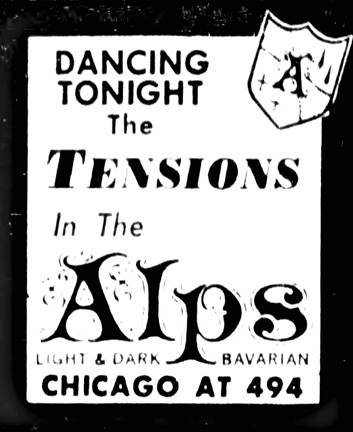
October 6, 1966
The place must have gotten too loud – in 1967 it had a “super soft” sound. The Insider reported that as of December 1968 it had been closed for many months because it was too noisy for an adjacent trailer court.
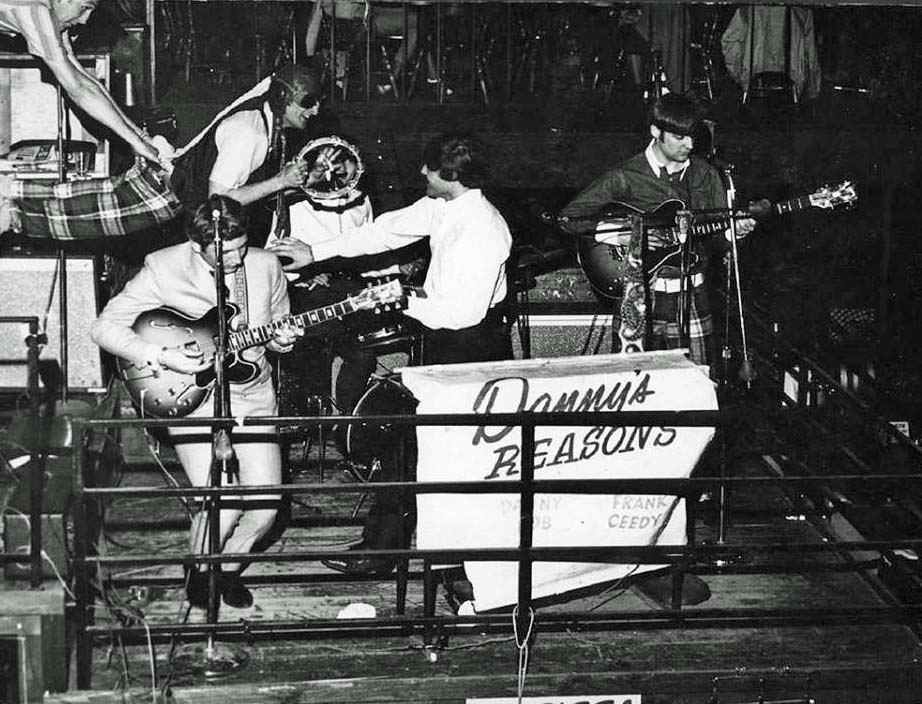
Danny’s Reasons at the Alps
The club voluntarily closed in January 1969 after the Bloomington City Council imposed regulations on noise affecting both the inside and outside of the building.
In July 1969, the building opened as Anthonie’s Clothing. Anthonie’s had previously been located at 4826 Chicago Ave. Anthonie’s was started by Anthonie (Tonie) Peterson, who had been in the clothing business since 1933.
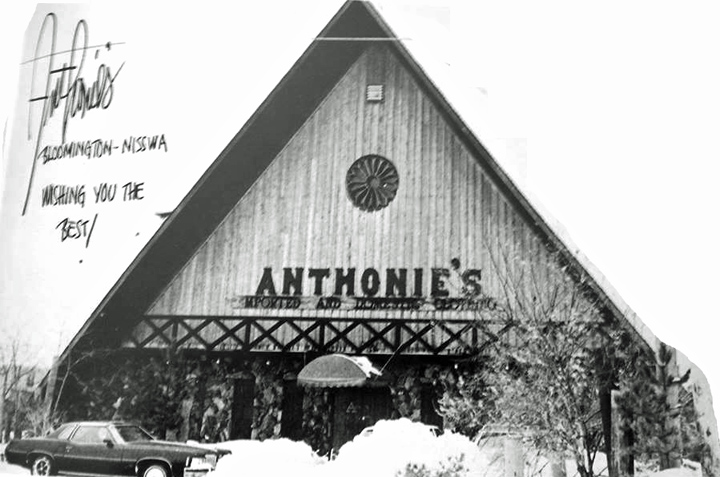
The following two photos come from what looks to be a postcard:
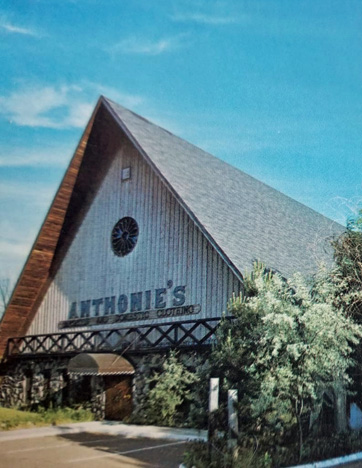
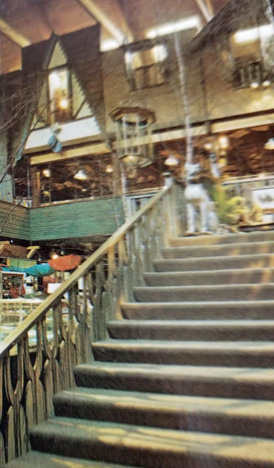
On December 8, 1974, fire swept through the back of the building, causing $50,000 damage to the structure and $200,000 damage to the inventory. Wells M. Gustafson, the owner of the building, expected insurance to pay for the damages. Witnesses saw children playing in the area prior to the fire around 8:00 at night. The store quickly recovered.
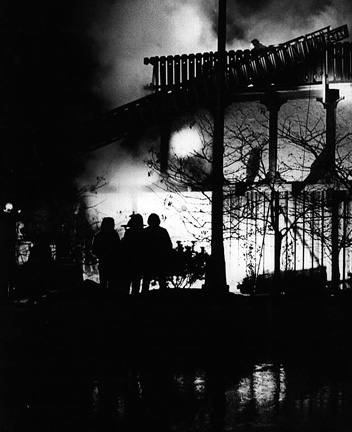
Photo courtesy Keith D. Kaiser
Anthonie’s closed in October 1989. Tonie Peterson died in June 1990.
On June 1, 1999, the building became A Frame Antiques, an antique mall with several vendors.
A new (1999) building sits at the site today.
Not sure a strip joint belongs here, but their ads appear in every paper, including the Minnesota Daily! One from December 1944 in the Republican Register advertises a show with a cast of 40, including Jessica Rogers and Jack Diamond. The ad doesn’t give an address but seems to indicate the name was Alvin and Hirsch’s. In 1952 Dagmar was all the rage.
Ambassador Motor Lodge, Highways 100 & 12 in St. Louis Park. The Ambassador (1961-1991) had three possible music venues:
- The Kashmiri Room was the main restaurant and had a dance floor. The Percy Hughes Trio was the house band from 1973 to 1982.
- The Cocktail Lounge might have had some live music.
- The Mandalay Lounge had a piano bar, for many years featuring Marilyn Sellars. It was apparently renamed Manders.

Entrance to the Kashmiri Room and a poster with entertainment info for the Manders Lounge
Located at 444 Rice Street in St. Paul, this was a three story building erected in 1920. Originally called the Deutches Haus, it was the center of German cultural activities and groups. The $180,000 building contained:
- A 1,000 seat theater
- Bowling alleys
- Pool rooms
- Conference roomss
- A rathskellar
- Dance Hall
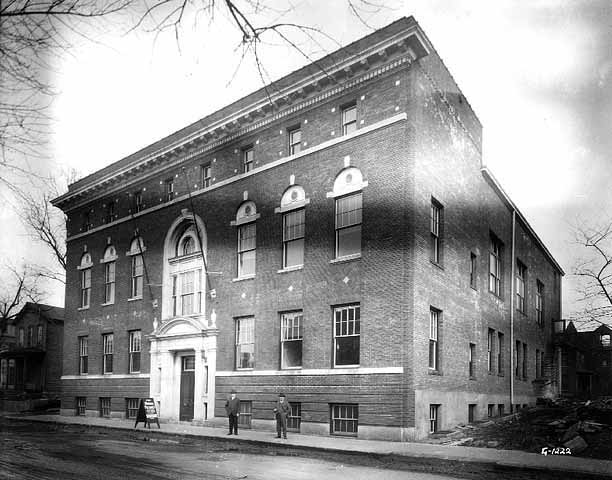
1920 Photo by Charles P. Gibson courtesy Minnesota Historical Society
Other names for the hall were:
- The German-American Hall
- The Dutch Hall
- The German Hall
- American Hall (1932)
- German Clubhouse
- German House
- Dutch House (1940)
On December 15, 1941, the members of the German House, formed in 1920, voted to change the name of the building from the German House to the American House.
The American House was a natural for polka dances:
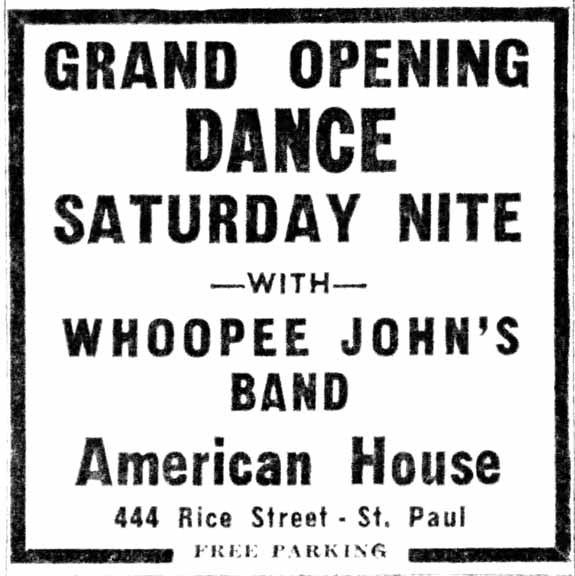
Minneapolis Star, October 19, 1945
WTCN broadcast Whoopie John from the American House on Saturday nights. This ad is from the Minneapolis Star, April 29, 1949.
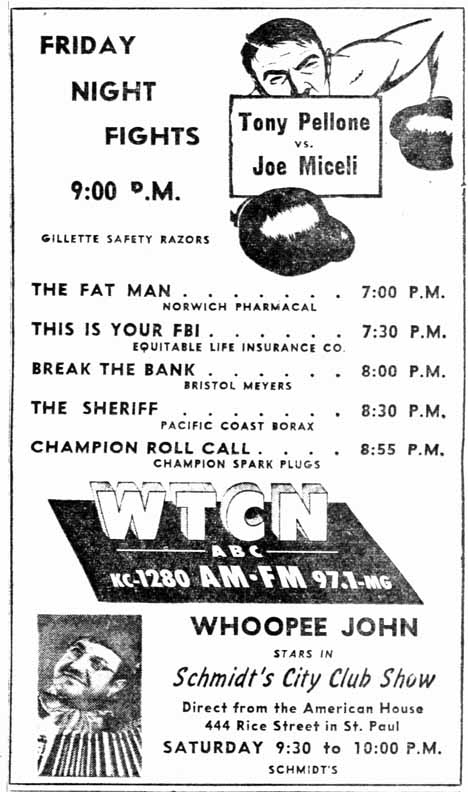
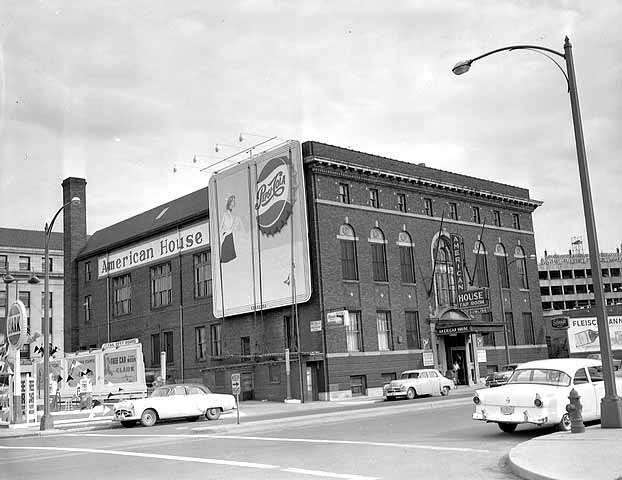
1955 photo courtesy Minnesota Historical Society
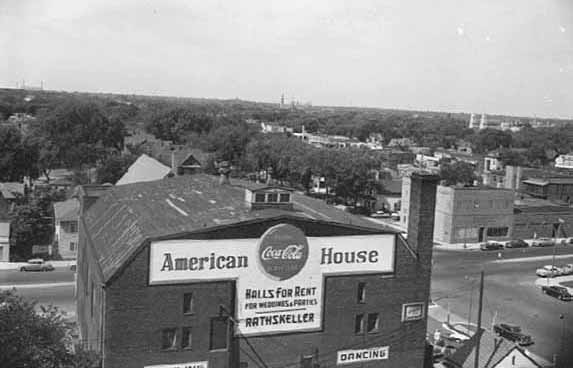
Photo taken September 2, 1955, St. Paul Pioneer Press, courtesy Minnesota Historical Society
On April 20, 1958, an ad appeared in the Minneapolis Tribune for an auction of all fixtures in the building, in anticipation of demolition. The building was removed for the Capitol Approach project.
Some information for this page came from the following source:
Jane McClure, “German House,” Saint Paul Historical, accessed September 20, 2018, http://saintpaulhistorical.com/items/show/226.
Ames Lodge, Number 106 of the Improved Benevolent and Protective Order of Elks – See Elk’s Lodge
Please see the Poodle Club.
Please see the Pink Pussycat.
Antlers Park was a 40 acre amusement park located on Lake Marion in Lakeville, Minnesota. Colonel Marion Savage built Antlers Park to attract passengers to the Dan Patch Railroad. The postcards below identify the owner as George O’Rourke.
Rose Anne Hanft:
In order to attract a multitude of passengers [to his Dan Patch Railroad, Marion] Savage put Antlers Park on the map [named in allusion to the former abundance of deer in this region]. It was located on the southeast shore of Prairie Lake [renamed Lake Marion in honor of Savage], and contained summer homes and facilities for picnics, boating, swimming, fishing, hunting and dancing. The excursion trains to Antlers Park were always very crowded. Those who remember riding these crowded trains remember the good times both on the ride and in the park.
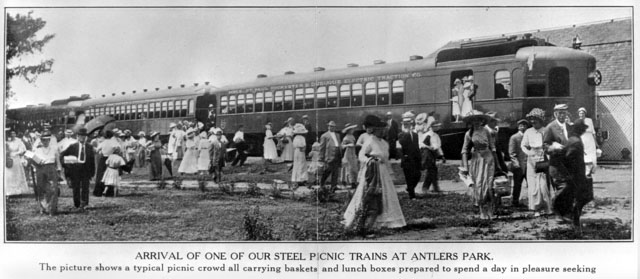
1925 photo courtesy Minnesota Historical Society
Whole families would make this trip, and, for the children, it was the big event of the summer. They would arrive at 54th and Nicollet early if they wanted a seat. At 11:00 am, a Dan Patch train pulled out of the terminal and headed south through the beautifully hilly country, past the many small stations named for the farmers whose lands the tracks cut through, past the Auto Club, the Savage farm, and finally reached Antlers Park. The people swarmed off the train and scattered to the different areas of the park. [A Minneapolis Tribune article dated April 7, 1912, reported that it took 40 minutes to get from the terminal to the park.]
The college groups usually went to the attractive pavilion. In one end of it, there was an ice cream parlor where sodas, sundaes, pop, but no liquor, were sold. The rest of the pavilion was a dance floor, tastefully decorated. Beautiful chandeliers hung from the ceiling, murals decorated the walls, and the floor was made of exceptionally fine wood. The open side of the dance floor had a vine covered walk. There was always a good orchestra and dances were 10 cents for a set of three.
The people had a choice of eating a picnic lunch on the well-kept picnic grounds or in an elaborate eating place off the grounds. In the evening a band played music out on the end of the dock. The little children had fun swimming in the clear lake and riding on the merry-go-round and Ferris Wheel.
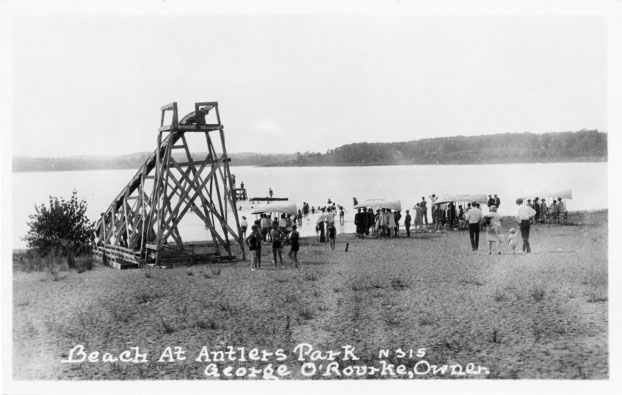
1925 photo courtesy Minnesota Historical Society
Everything in the park was up-to-date, including electricity. The means of obtaining electricity was unique. The engines of the Dan Patch provided transportation to and from the park, and the number one engine of the road, the Augerita, supplied all the electricity for Antlers Park. The Augerita ran for only one year, and because of her small passenger capacity, she was put on a siding in Antlers Park where her powerful engine generated all the electricity for the park’s facilities. [A Minneapolis Tribune article dated April 7, 1912, reported that an electric light plant was being installed at the park.]
From the Lakewood Area Historical Society:
Antlers Amusement Park became one of the most famous amusement parks in the upper Midwest. It contained a lavish dance pavilion with a gleaming oak dance floor; a large bathing beach that featured a dock, diving tower and high sliding chute; a boat dock that offered sailboats, rowboats and canoes; a children’s playground with a miniature operating train for children; tennis courts; an athletic field and baseball diamond with a grandstand for spectators; and an aerial swing. A nine-hole golf course was located nearby. The Dan Patch Railroad Line [provided transportation to the park.] Luxury excursion cars with real leather seats, stained glass upper windows, and richly carved and inlaid wood brought thousands of visitors to the park each summer. On weekends in the summer of 1912, these trains reportedly made 19 scheduled runs each day.
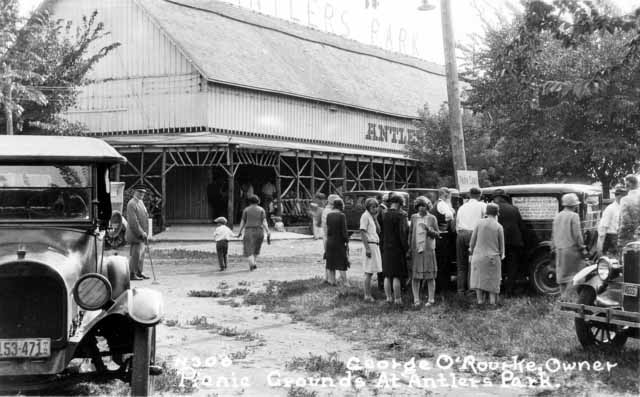
1925 photo courtesy Minnesota Historical Society.
The area was already popular with wealthy families from southern states who came to escape summer heat and humidity. These families and other visitors stayed in cabins located around the lake or at Weichselbaum’s Resort, which was famous for its fried chicken, apple pie and homemade ice cream. The amusement park declined in popularity in the 1920s and 1930s due to a combination of factors – the advent of the automobile, the Great Depression, and several dry years that saw Lake Marion drop to its lowest level ever.
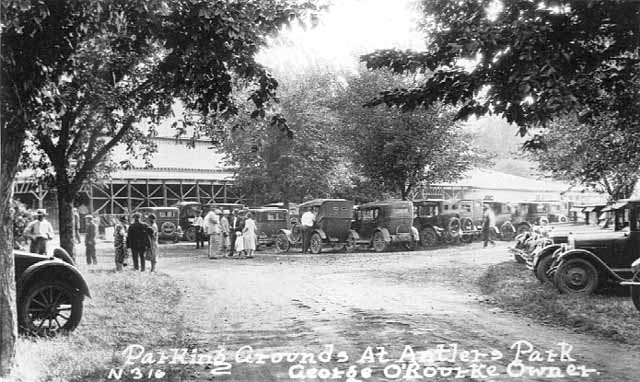
1925 photo courtesy Minnesota Historical Society
One reader tells us that “in the 1960s and early 1970s it regularly hosted picnics for many thousands of people on weekend days during the summer, typically sponsored by major corporations and unions in the Twin Cities metropolitan area, e.g., Northwest Airlines, IBEW, UAW, Honeywell, and Hitchcock Industries. When the last owners retired, they sold the park to the city of Lakeville.”
Antlers Park is still there, but no longer an amusement park. It is described as a playground, and according to pictures on an unofficial Facebook page, it has a sandy beach and a covered picnic table pavilion.
Please see the Kistler Building for information about Apex Hall.
The Arabian Nite Club was originally located at 628 Central Ave. NE in Minneapolis. The first ad found was in 1932.
In March 1935 the Club was sold, and apparently moved to 21 Washington Ave No. in the Gateway (Skid Row).
In January 1948, owner Anna M. Buczak transferred the liquor license to her mother, Rose C. Buczak.
In February 1962 the bar had been demolished in the name of slum clearance. Mrs. Buczak tried to transfer the license to 213 N. First Street but was denied. She was denied a second time, and then Peacock Alley tried to get the license but was denied, allegedly on racial grounds.
This venue was located at 315 So. Fifth Street.
See Dreamland Dancing Pavilion.
By the Fall of 1934 the building was called the Aragon Ballroom, and remained so until at least New Year’s Eve 1935. The Aragon Ballroom Orchestra was broadcast over WTCN radio.
The Aragon was more of a venue for the small Minneapolis black community, as evidenced by ads for dances in the Minneapolis Spokesman. I will list the ones I found:
The Clover Leaf Club Presents Joe Billo and His Band: 12 Artists
Monday Nite, September 17, 1934
ARAGON BALLROOM (Formerly Acadia)
Come and Dance to One of the Nation’s Greatest Bands
THE BIG DANCE OF THE SEASON!
The Clover Leaf Club Presents Eli Rice and His Cotton Pickers
15 Superb Musicians and Entertainers
Next Monday Night, October 1, 1934 at ARAGON BALLROOM (Formerly Acadia) Everybody Will Be There!
Dance at the ARAGON (Opposite the Court House) Monday Night, June 17, 1935, Featuring The Harlem Play Girls – First Time Girls’ Band to appear in Minneapolis. Their Only and Last Appearance Before Leaving for Tour of the West Coast. Admission 40c Make up a Party!
Coming Monday Night, July 15, 1935 – Carroll Dickerson and His Orchestra, Direct from the Grand Terrace Cafe, Chicago. Also Recently Featured: 14 CBS Radio Artists at the ARAGON BALLROOM, MINNEAPOLIS
For First Time Hear and Dance to the Music of Earl Fraser and His Band at the Beautiful and Spacious ARAGON BALLROOM (formerly Arcadia) – Across from Court House. Monday Night, September 16, 1935. “Everybody Attends Dances at the Aragon” Come out, hear the newest and most sensational band in Northwest
Coming Monday Night, October 7, 1935: Walter Barnes and His Famous Royal Creolians (Chicago’s Favorite Band) ARAGON BALLROOM Biggest Dance of the Season Admission 50c
FITE-BAKER and their HARLEM HI-HATTERS
ORCHESTRA AND REVUE
FLOOR SHOW FEATURING BUDDY SHORT, VELDA SHANNON, CARROLL WATKINS 10 ARTISTS AND ENTERTAINERS
ARAGON BALLROOM Monday Evening, October 28, 1938.
Admission 50c
“The Event of the Season” Reese Martin presents
RED PERKINS and his Dixie Ramblers playing for a Dance at the ARAGON BALLROOM, Monday Night, November 25, 1935. Dancing 10 pm to 2 am. Four Thanksgiving Turkeys Given Away Free
BIG NEW YEAR’S EVE DANCE
Featuring Walter Erickson’s Red Hot Band at the Spacious ARAGON BALLROOM, 315 South Fifth Street
The first time in the Twin Cities that the colored people have been able to ssecurie such a lovely ballroom on a holiday. For reservation call Bridgeport 3519.
FAVORS GIVEN AWAY FREE Dancing from 9:30 to 4:30
COURT HOUSE GARAGE
From August 1936 to 1945 the building was used as a public storage garage.
HERTZ
In July 1945 the building was purchased by the Hertz Driv-Ur-Self System for $50,000. Hertz used it for storage and servicing its cars. Hertz intended to construct a second story and connect them with ramps, but permit records do not indicate that this was done, and postwar building material restrictions probably made this plan unworkable. The building was purchased from Mrs. Alice Strass/Straus Landers of St. Paul/Pasadena.
The building was demolished in October 1961.
The Arcade Bar was located at 932 Arcade Street at Sims Avenue in St. Paul. It was two blocks from the Whirlpool plant, and a popular place for workers until the plant shut down at the end of 1984.
It was just a bar, I’m told, but Mark Youngblood comes up with these great ashtrays, so I decided to put this up.
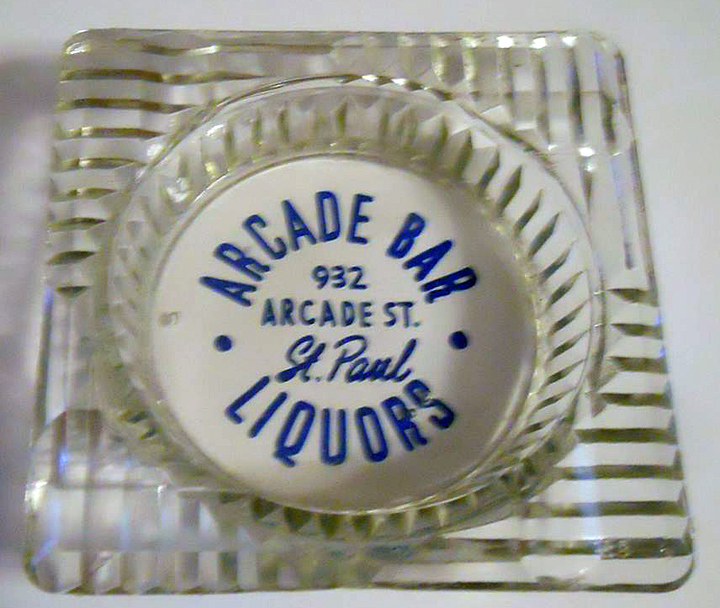
From the collection of Mark Youngblood
Then comes Henry Feist, who confirmed that it was just a bar. But, writes Henry:
The only times they would have live music was to rid the bar of the motorcycle clubs (who wanted to make it their hangout), by playing music that was not to their liking (which was seldom). I know this because my uncle(s) owned the place from the early ’70s up until about eight years ago.
Mr. Feist also tells us that the place was originally built as the Northwestern Hotel in the 1880s, and guided me to this photo:
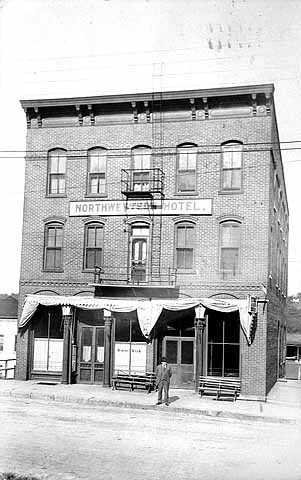
Northwestern Hotel. Photo courtesy Minnesota Historical Society
In 1942, the proprietor of the Arcade Bar was identified as Hugo Wollney. In July 1950, the owner was Frank C. Graves. In August 1960 to December 1965, the proprietor was identified as Harold Hicks.
Michael Feist was identified as the owner in 1987 in a disciplinary hearing about gambling and being open before 8:00 am (Minneapolis Tribune, July 15, 1988) On July 19, 1988, the Bar received an 11-day suspension for those violations.
This venue at 315 So. Fifth Street started out in 1909 as the Dreamland Dancing Pavilion.
ARCADIA ROLLER SKATING PALACE
In 1914, the building was leased by the Saxe Brothers, theater owners and amusement promoters. They opened the roller skating venue on December 5, 1914. It could accommodate 1,000 skaters, and boasted skates with the latest fiber rollers. Cornelius A. Lane was the manager.
ARCADIA DANCING PALACE
Apparently roller skating wasn’t catching on, and the building reverted back to dancing or a combination of dancing and skating on April 10, 1915. It also hosted many boxing matches, and in fact hosted many of the kinds of events that would later be held in the Minneapolis Auditorium. These included political meetings, receptions, even a poultry show.
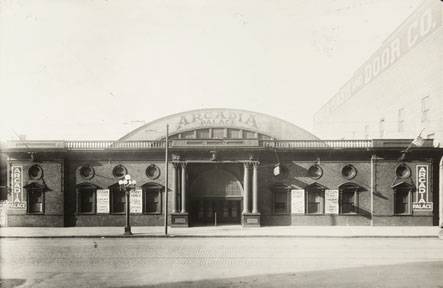
1918 Photo of Arcadia Palace courtesy of Minnesota Historical Society
And there was dancing! Proof is this report that poor James Kelly was arrested and fined $10 for refusing to stop “shimmying” at the Arcadia Dance Hall. The judge warned him to “keep away from dance halls until you can control yourself.” (Minneapolis Tribune, February 22, 1920)
Oh, and there were pickpockets galore.
In 1922 Conway and his bouncer were taken to court for police brutality by a drunk who was ejected too forcefully.
In 1923 it was becoming clear that Minneapolis needed better facilities for its events. A bond issue was being discussed for a modern auditorium, after using using the Arcadia, the Shubert Theater, the Minneapolis Steel and Machinery Plant, and “the auditorium” proved to be inadequate.
There was a busy schedule here in December 1925:
- Enagma (sic) Club Dance on Tuesday nights
- Lucky Prize on Wednesday nights
- Club dance every Thursday night
- Candy Dance on Friday nights
- Saturday and Sunday follow the crowd to the Arcadia Dance Palace.
Now, I must explain about the information above. It comes from a publication called the American Constitution, which was an anti-Communist newspaper. And why was I reading an anti-Communist newspaper, might be a fair question? The Minnesota Historical Society’s microfilm room has some reels of newspapers they might just have a few copies of, and these are all spliced together into a delightful potpourri of publications that are a hoot to look through. So this came from that. I suppose a Communist could go to Conway’s Arcadia Palace just as much as anyone else as long as they didn’t make a fuss about it…
In 1928 the Manager was William T. Hawks.
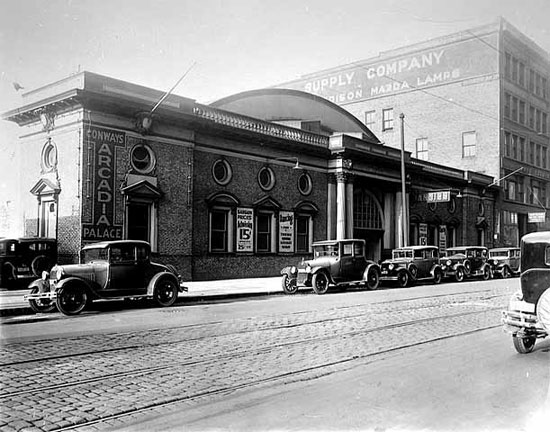
1933 Photo of Conway’s Arcadia Palace, courtesy Minnesota Historical Society
See Aragon Ballroom
Archie’s was located at 1022 Excelsior Ave. (now Mainstreet), Hopkins.
The building goes back to 1930, and in October 1937 it was Gluek’s Corner, a place to get Wrigley’s Gum.
ARCHIE’S
Archie was Archie Normandin, and his bar went back to at least 1951. In 1971 you could dance to your old time and new favorites to Chris Kober and His Orchestra. Also Country and Western by the Big River Ramblers.
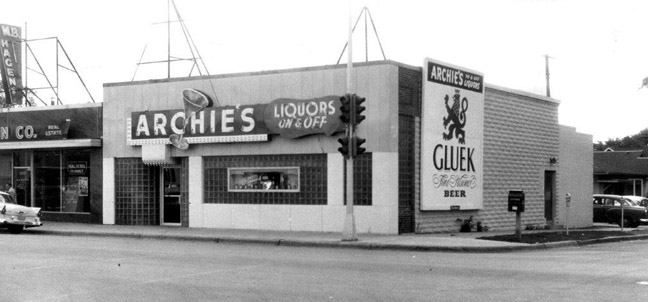
Archies, 1956, Courtesy Hopkins Historical Society
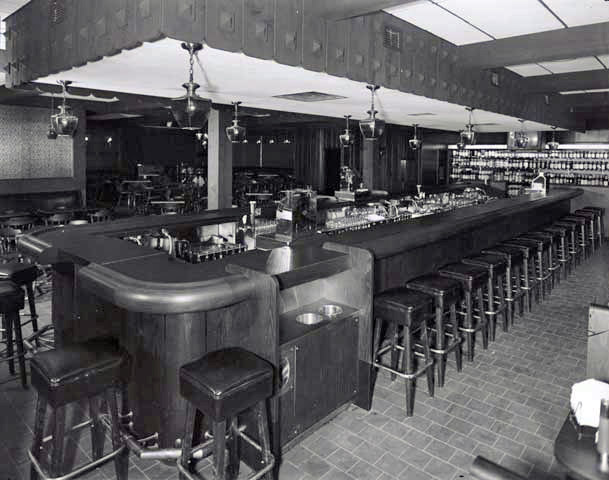
Inside of Archie’s, 1958 – Minnesota Historical Society
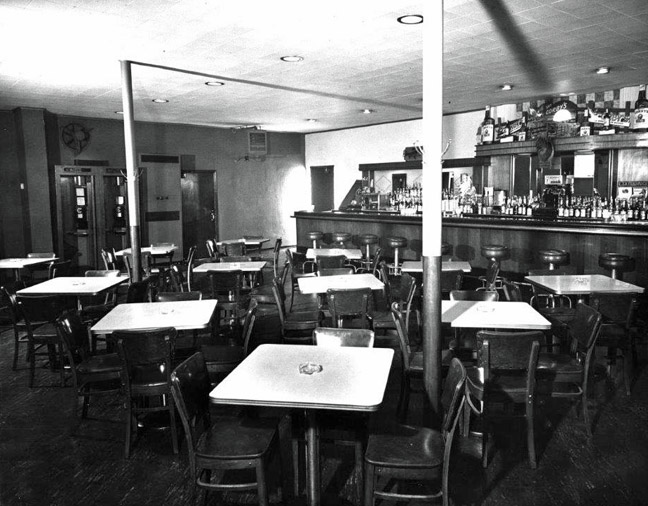
Another view of Archie’s, @ 1960 – Hopkins Historical Society
On November 18, 1977, the Minneapolis Star did a survey of Country bars around town, and included Archie’s. The bar was called a comfortable, relaxing spot with two levels and adequate seating. The Country decor was deemed a bit “contrived.” The dance floor is slightly elevated and gets crowded when the band is playing. Patrons are clean-cut business and factory workers from the area. There was live entertainment every other night.
Archie’s prevailed until at least May 2000.
DECOY’S
In January 2001, wantads appeared for staff for a new place called Decoys, which apparently opened in October 2001. Decoy’s offered live music and existed until at least December 2008.
THE WILD BOAR
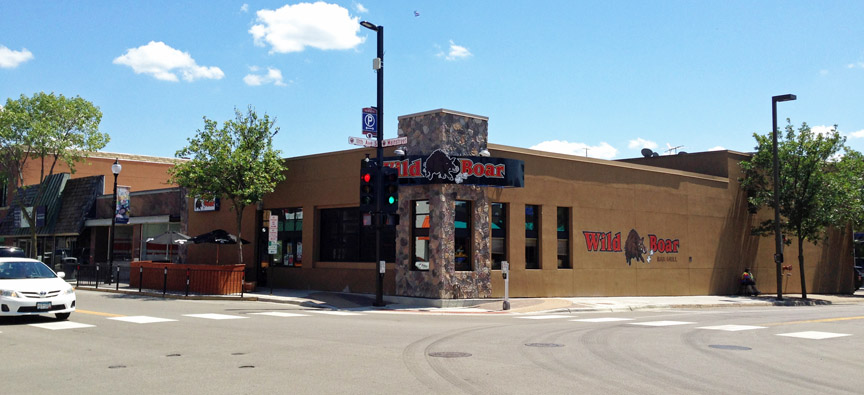
Archie’s is the Wild Boar in 2016
The Ark Auditorium was located at 3044 First Ave. So. in Minneapolis. It was built by the Ark Lodge of the Masons, opening on December 1, 1908.
The building had three stories, withe the first dedicated to the auditorium, the second to meeting rooms of the Masons, and the third to a private banquet room. Part of the building was leased to the West Side Commercial Club beginning on January 9, 1909.
Many, many meetings, dances, picnics, revivals, and other gatherings were held in the building over the decades. In the days before reliable transportation, local groups had to rely on themselves for entertainment.
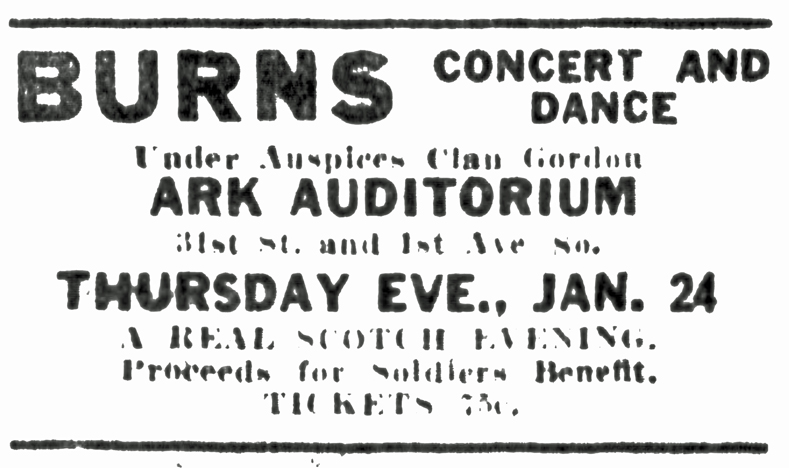
1918
In 1924 the Minneapolis Social Club was incorporated as a nonprofit organization, and held a Saturday night dance every week at the Ark Auditorium.
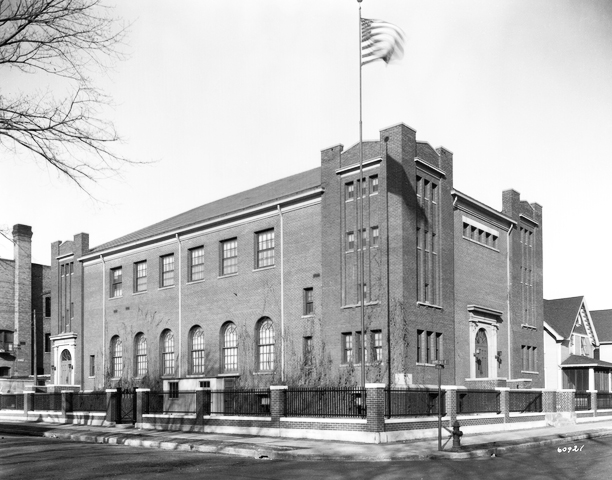
1925 Photo courtesy Minnesota Historical Society
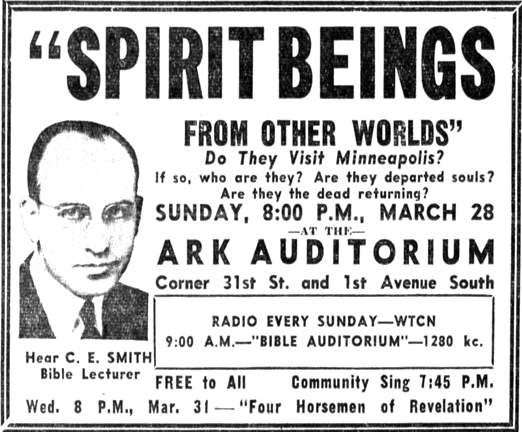
March 1943
Notices are seen in the Strib until November 12, 1969.
At some point the effects of the Ark Lodge were brought over to St. Louis Park’s Paul Revere Lodge.
The building was demolished in September 1976. A U.S. Post Office was built on the site the following year.
1619 Plymouth Ave. No., opened in November 1957 offering Southern style food and Your Favorite Dinner Music Presented Live. Owned by Timothy Bender and Phillip Archer.
Please see Worwa’s.
26th and Nicollet, owned by Bill Warner.
The Attic was in Chanhassen, 1972.
The Auditorium Bar had two locations.
1400 3rd Ave. So.
The first Auditorium Bar had been owned by Louis M. Palmersten, son-in-law of Syndicate member Harry Smull.
1376 Nicollet Ave. (Kenesaw Hotel)
In July 1963 Palmersten had his license transferred to the Kenesaw Bar, located at 1376 Nicollet Ave.
Kenesaw Bar: March 1959 to early 1961. A Kid Cann Syndicate site. In 1960 the liquor license was in name of Yiddy Bloom’s sister, Kid Cann’s sister-in-law.
The Auditorium Bar was reopened at the Kenesaw site in December 1963.
Hylander Supper Club: December 1963 (1372)
Auditorium Bar: November 1965 (1372)
The address was last mentioned on September 18, 1967.
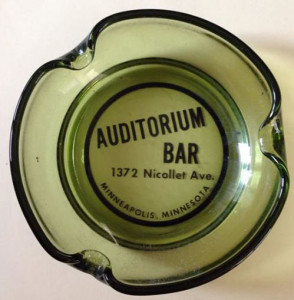
From the collection of Mark Youngblood
The 1372 address was generally used for Dantis Restaurant and Bar. There were three addresses that got mixed up: 1370, 1372, and 1376.
Pinning a construction date down for this building is beyond my capabilities, I’m afraid. The City/County says 1885, although there are newspaper ads for stoves and heaters that go back to 1877. Permit cards seem to indicate that one of perhaps two buildings on this lot burned down before the turn of the last century, while another was replaced in 1909.
- In 1909, John and Sam Friedman secured a 10 year lease on the L.M. Stewart property and “remodeled” it by tearing down the old structure adjoining the one at 424 Hennepin.” But then it says they leased the ground at 424 Hennepin from “Elder Stewart and built thereon a building to suite their own convenience, adaptiable to their special line of business. The new structure is 22 x 80 feet and is two stories high. It has a swell front and is attractive in architectural design.” (Minneapolis Tribune, April 4, 1909) Friedman Bros. was a tailor shop/haberdashery until 1926. John Friedman also ran a real estate business out of the building.
- The Oriental Cafe opened to much fanfare in May 1913, but by June, owner Moy S. James had not paid any bills, was on the run, and his creditors were dismantling the place.
- Minnesota Meat Co: 1931 – 1936
The music venues here were:
- Lindy’s
- Crombie’s Bar and Lounge
- Augie’s
LINDY’S
Lindy’s was a “stage bar” that opened on June 11, 1936.
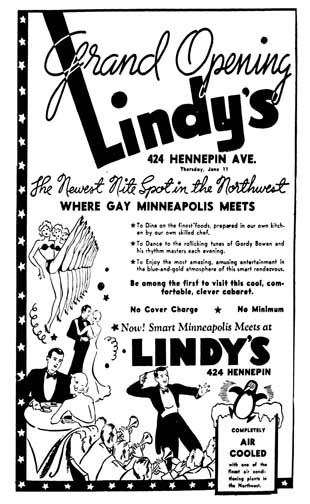
Minneapolis Tribune, June 11, 1936
The photo below is from an undated ad – courtesy Anne Cook/Gurr photo collection. It was sent by David Eyre, whose Aunt, aunt Flora Cook/Moore/Egan (1888-1960), worked as a “Psychic Reader [who] gives readings to patrons every afternoon.” Flora’s photo, also from the Anne Cook/Gurr photo collection, is below.
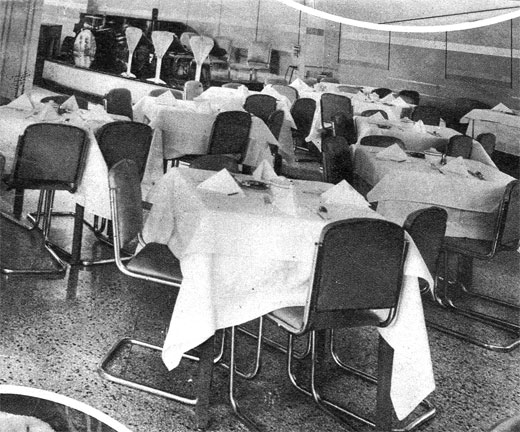

The ad has more!
- Anytime is “Swing Time” at Lindy’s with music for dancing delightfully supplied by Les Martin and his orchestra . . . swing time or waltz time . . . you sway and dream to the contagious rhythms of this syncopated combination.
- After the game – here is where you will find the winners celebrating their victory and the vanquished forgetting their defeat in the merry atmosphere of Lind’s Football Supper Dances Saturday afternoons starting at 5:00 o’clock.
- The World Famous Siamese Twins . . . Daisy and Violet Hilton, whose personal appearance at Lindy’s brought thousands of new visitors to this popular downtown club . . . an example of the famous stage personalities that are featured in Lindy’s floor shows every week.
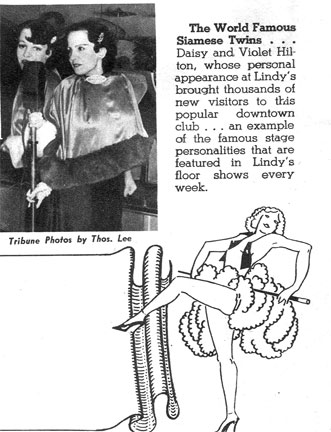
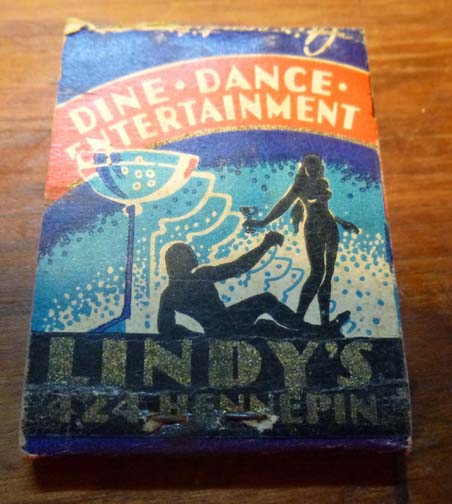
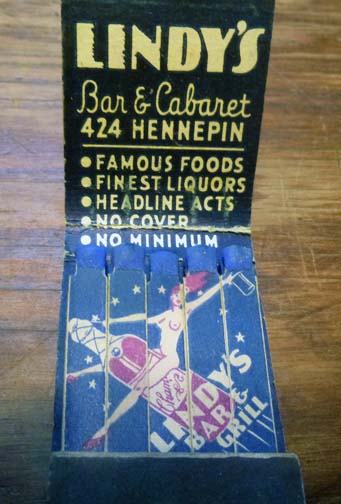
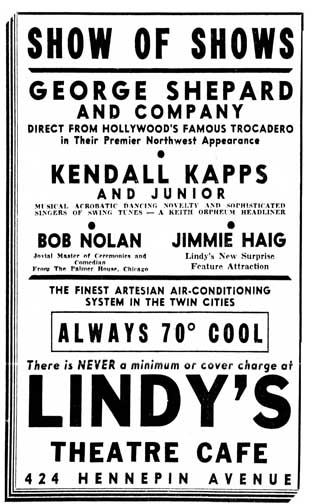
Minneapolis Star, June 4, 1937
CROMBIE’S BAR AND LOUNGE
Crombie’s replaced Lindy’s between September 1938 and August 1939. Crombie’s was owned by Benjamin Moses. But Moses apparently died in about July 1943, as the bar was up for sale by Max Moses, Administrator of Estate.
Stebbins:
Some time between 1936 and 1939, when it became Crombie’s Bar, Howard “Chief” McElroy had a band there which he believes was the first Dixieland band in town.
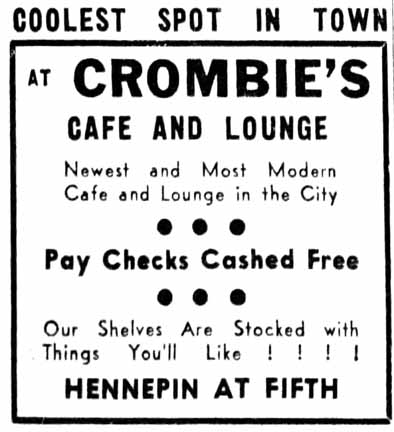
Minneapolis Star, June 16, 1939
Crombie’s was advertised up until at least September 1943.
AUGIE’S THEATER LOUNGE AND BAR
If there is one place that defined Hennepin Avenue, it was Augie’s, owned by Augie Ratner. Let’s take a look at this colorful figure.
AUGIE RATNER
- 1902: Samuel “Augie” Ratner was born on March 15 in Minsk, Russia
- 1909: He came to the U.S. at the age of 7 (later amended to age 8).
- The 1910 Census found him in Minneapolis, speaking Yiddish as his primary language. His father was a grocer.
- 1911: He was naturalized.
- By 1917, at age 15, he appeared in the papers as a boxer and was apparently quite active.
- The 1920 Census finds him living with his parents at age 18 with no occupation listed. A 1920 article article described him as a “Brooklyn middleweight” who had been in the Navy.
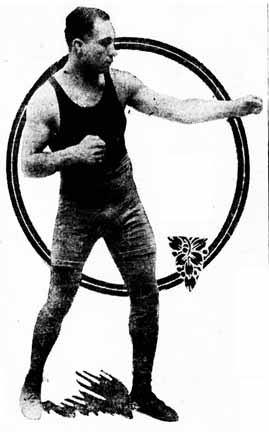
Augie Ratner, Minneapolis Tribune, March 7, 1920
- The 1930 Census said he was the proprietor of a “Confectionery,” which was code for a speakeasy.
- In October 1933 we find him as the manager of Club Royale, 20 University Ave. SE. He was awarded a license for the club in April 1934.
In 1935 he owned a service station, and indeed there was this ad found from 1935. The 1940 Census describes him as a partner in a gasoline station.
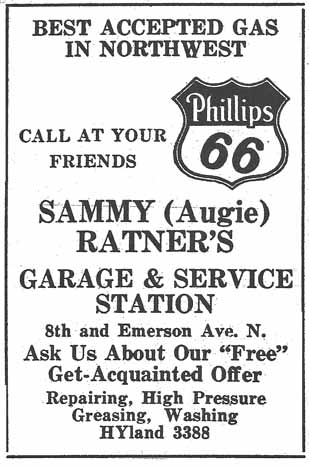
- 1936: But when a gambling house at 1711 Plymouth Ave. No. was robbed by other gamblers, and he was accused of being one of the owners of said gambling house, his response was a resounding “Baloney!” He did, however, find it convenient to pay a visit to Rochester, all the while denying a gambling war. “I sell gas and oil. That’s my business. Anything else is a lot of baloney.” (Minneapolis Star, December 21, 1936)
- An ad for the gas station appeared in the Minneapolis Star Journal in December 1940.
AUGIE’S
- 1943: Augie’s opened in or before November 1943.
The Republican Register of December 1943 ran an article about the new bar, calling it “one of the city’s most popular fun spots.”
When Augie took over Crombie’s, it was entirely redecorated by Joe Palen. The article concludes “..Ratner employs only veteran concocters of fancy drinks and only the highest quality beverages are dispensed.”
The first performers at Augie’s were Leon Abbey’s Entertaining Boys (his four piece orchestra) and singer Jeanne Bargy, daughter of orchestra leader Roy Bargy. In addition, Dorothy Berry will sing your favorite request.” Another early band was Howard Brown’s Rhythm Kings.
The City Permit card says that the two top floors, that had contained a hotel, were removed in about April 1946.
An undated and unsigned memo (probably from the mid 1940s) says that Elaine Realty Inc. bought the building from United Properties Inc. on October 26, 1946, but suspects that Tommy Banks may have held the deed. (Hennepin County Library Special Collections Clipping File)
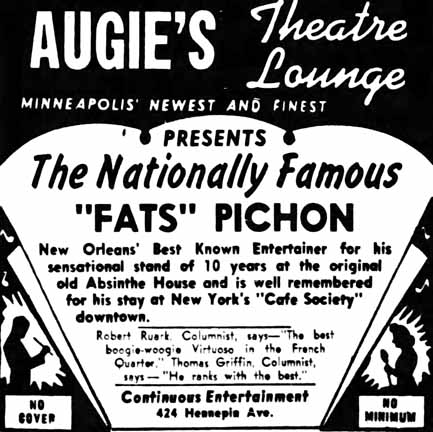
June 24, 1951
In 1955-56 the bar featured Wild Bill Boone.
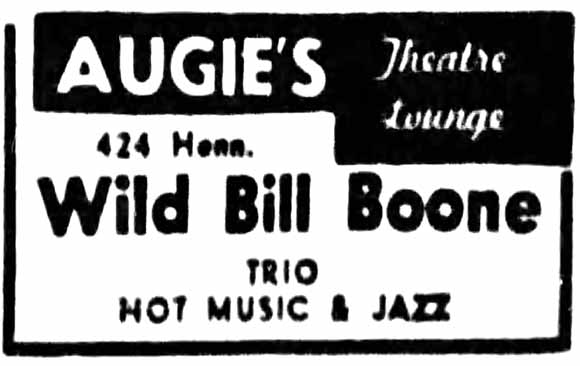
November 23, 1955
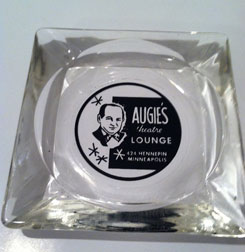

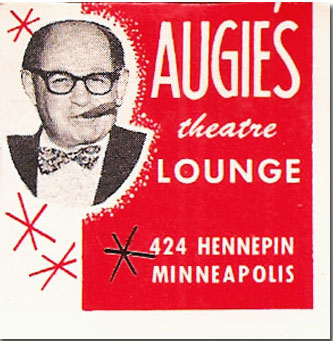
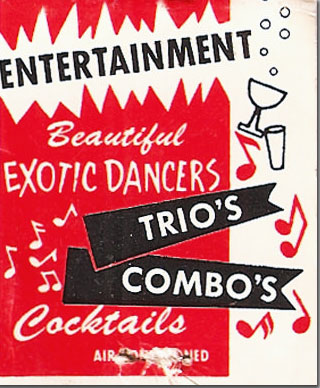
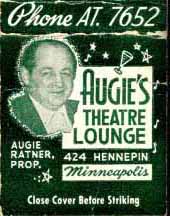
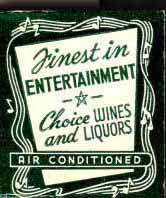
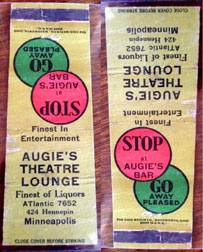
On Facebook, Augie’s daughter tells us that Augie sold the bar, along with the name, to a friend in 1966. Augie died on August 1, 1979.
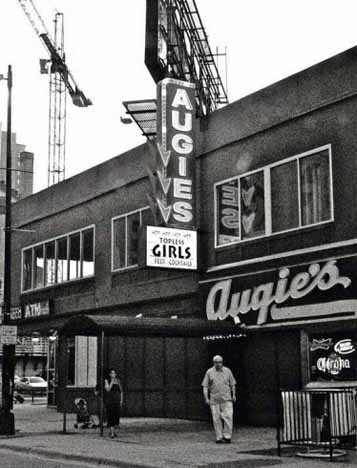
Photo source unknown
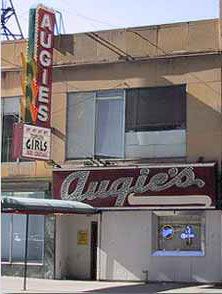
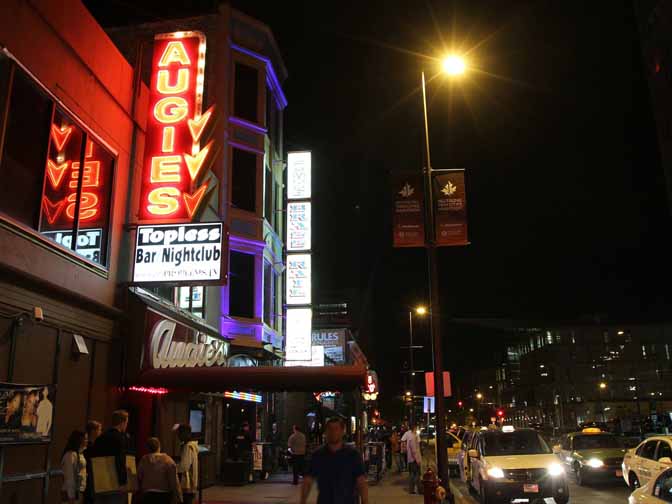
Apparently Augie’s is still there, now Augie’s Bourbon Street Cabaret.
The B and L Tavern was located at 156 West 7th Street/St. Peter Street in St. Paul.
It was one of the early taverns that sprung up right after Prohibition ended. The only hit in the Minneapolis newspaper database is on November 2, 1934, in an ad for Calvert Whiskey. The St. Paul newspapers are not online.
But the photo below tells us that in 1937, there was an orchestra every night, and those key words “dine and dance” allow us to add this fine establishment to our list of music venues!
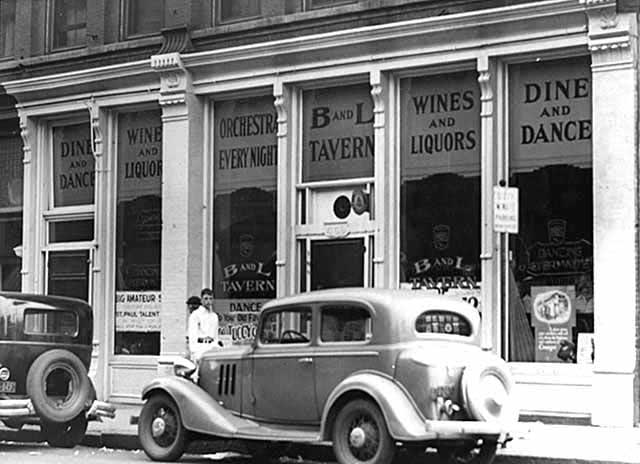
1937 Photo courtesy Minnesota Historical Society
St. Paul – jazz venue. Is this really the B & L?
Information for this page comes from the book Looking Back at White Bear Lake: A Pictoral History of the White Bear Lake Area, by Cynthia E. Vadnais.
This venue was located on the southwest corner of Bald Eagle Avenue and Bald Eagle Boulevard West, in White Bear Lake.
HOTEL BENSON
In about 1885, Frederick W. Benson operated the Hotel Benson at the Bald Eagle Lake resort.
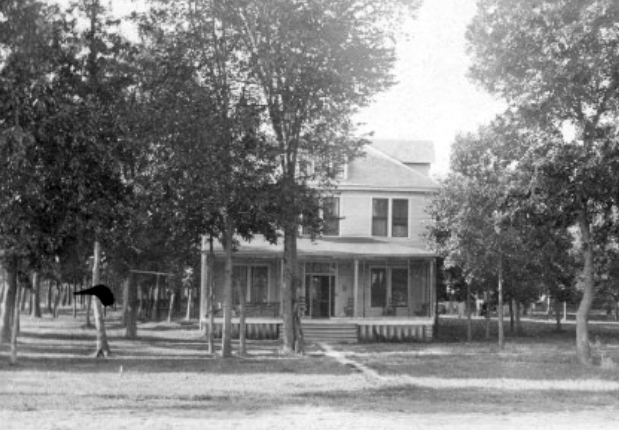
Hotel Benson, 1900. Photo courtesy White Bear Lake Area Historical Society
BALD EAGLE HOTEL
During the early 1900s, C.E. Smith purchased the resort and changed the name of the building to the Bald Eagle Hotel. The establishment boasted electric lights, running water, sanitary closets, bathhouses, boats, fishing tackle, and bait. They also offered “moving pictures” on-site and a dance hall. For almost four decades, the Smiths ran or leased out the hotel.
Vadnais:
During the late 1910s and early 1920s, the Smiths had the Smith’s Bald Eagle Air Dome [?] at the hotel. They advertised that there were “moving pictures, dances and refreshments” with “dancing every day (except Sunday.)” Dances cost 5 cents, for which customers received two dances (per couple). There were also dances that included movies. These had an admission price of 10 cents, which included one dance per person.
APARTMENTS
Vadnais:
In the 1940s, Joe Rogowski took over the hotel, converting it into apartments.
ROGOWSKI TAVERN AND BOATS
He opened Rogowski Tavern and Boats on the premises where tourists and locals could have a drink, rent a boat, or purchase snacks. The automobile had done away with the need for overnight housing for almost anyone coming from the Twin Cities to fish or enjoy other recreation on Bald Eagle Lake.
The building was torn down in the 1970s.
Please see Lee and Eddie’s.
See the Cabaret, St. Paul.
Please See Stagecoach
This music venue called the Barn, not to be confused with the Purple Barn, was located on Highway 18 (now 169) and 42nd Ave. North/Rockford Road. This is now a major cloverleaf.
According to the ad below, it opened on October 7, 1957, by Gene and Jerry Schmidt. I was just lucky to run across these ads – there’s no way you can search for a phrase called “The Barn!”
After asking for any information about this Barn, I was contacted by a relative of the Schmidts, Bradley Breitzman, who spoke to one of the six Schmidt siblings. Thoughts of the Barn brought tears to the old man’s eyes – he did not remember seeing these ads! He said that it was an actual barn – the family lived upstairs, and the bar and cafe were downstairs. There was another house on the lot. They still have the cash register! Bradley is looking for photos of this wonderful place, so stay tuned!
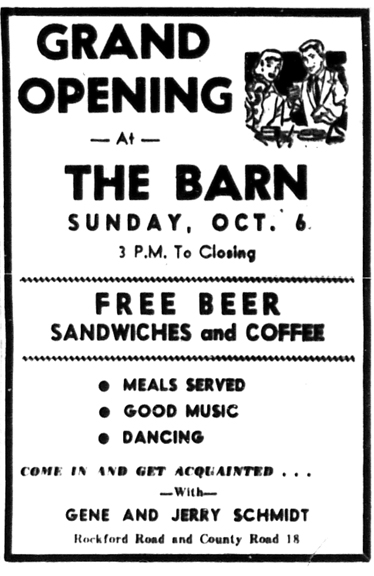
North Hennepin Post, October 1957
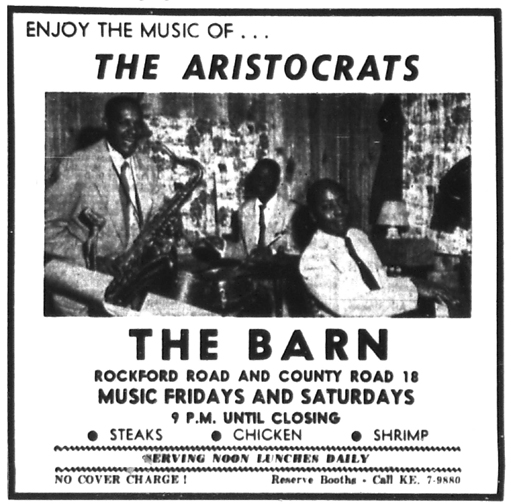
North Hennepin Post, November 14, 1957
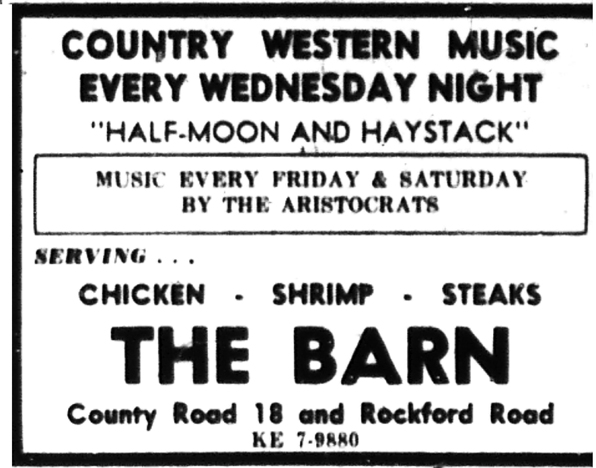
North Hennepin Post, May 1958
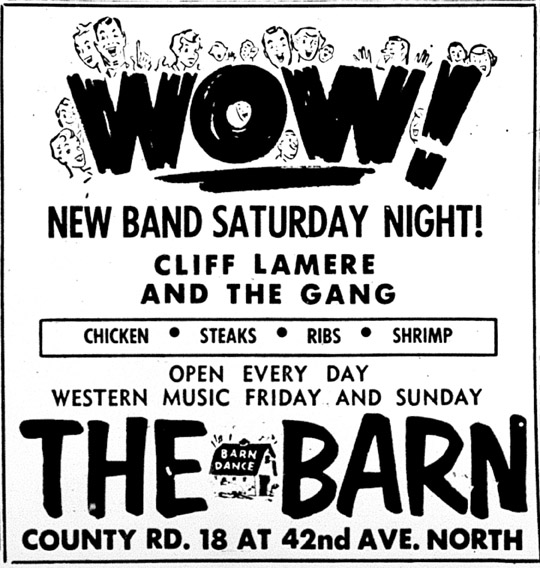
September 1, 1960.
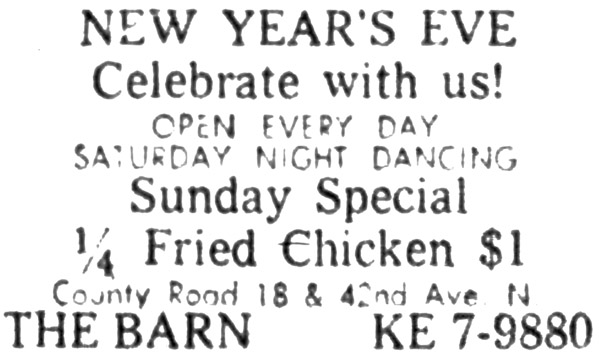
Minneapolis Star, December 29, 1960
32 South 6th Street, upstairs. After hours jazz and gambling hangout.
St. Paul dancehall (barn) owned by WLOL DJ Throck Morton. House band the String Kings.
This site at 313 Oak Street SE near Washington Avenue on the U of M Campus was the site of two cool coffee houses:
- The Bastille
- The Coffee Break
BUILDING HISTORY
The permit cards say that a house was moved onto this lot in 1905, with many alterations and additions after that. In 1908 it was described as a little cottage, the home of the beleaguered Andrew Stevens, whose wife died in childbirth, leaving him with eight children under the age of eleven.
In 1925, Miss Mai Marie Stevens tried out for the Daily Star Vanities, to be performed at the Seventh Street Theater. Andro and Anna Stevens continued to live here until Anna died in 1939. Andro remarried (it turned out Virginia was his third wife) and when he died in 1944 he left everything to Virginia, to the consternation of his four sons and three daughters. His will was determined to be valid by the court.
In 1930 the building was concurrently the home of Mr. and Mrs. B.A. Skinner. Bertha Skinner died in 1941.
THE BASTILLE
In 1960, Harvey Abrams and Bob Beull rented an old house near Oak and Washington Ave., rebuilt it, and named it the Bastille. Abrams, described by Robert Shelton as a “student radical and folk-song enthusiast,” told Shelton that Bob Dylan, then performing as Bob Dillon, played at the Bastille in the fall and early winter of 1960. (Robert Shelton, No Direction Home: The Life and Music of Bob Dylan, 2011)
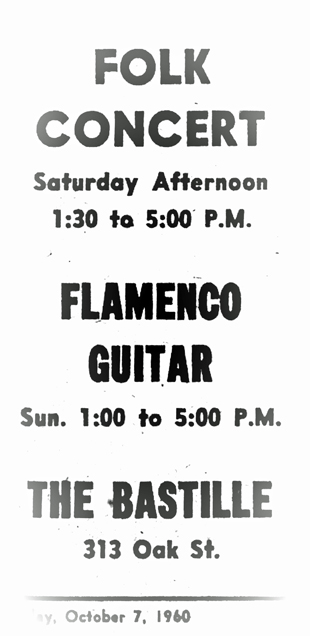
Minnesota Daily, October 1960. Image courtesy Melinda Russell
COFFEE BREAK
The Coffeebreak, owned by Mel Leslie, opened in March 1961.
A January 1963 ad in the Select Twin Citian describes it as having a “‘Bohemian’” coffee house atmosphere on the first floor of a frame house next to the Campus Theater. “Dusty wooden floors, fish nets, stained glass windows. Authentic Negro blues performed by Dave Rey (sic). Friday and Saturday 9:30 to 1:30 am.”
Entertainment featured local blues artists such as Dave Ray and Tony Glover, and occasionally nationally-known performers like Rev. Gary Davis and Big Joe Williams. Performers received half of the $1 cover charge at the door.
“You could smell the hot cider when you walked in the door, recalled Leslie. It was very dark, with fishnets on the ceiling, a small platform and stained glass wind wind with lights behind them. The Break was a place to play chess, do book work, hang out, for coffee and swap songs and guitar work.”
Alan Slacter remembered:
The Coffee Break was my go-to, more approachable than the Scholar, and served hot apple cider in large stoneware mugs. Danny O’Keefe also played there and would accept requests, including one of my favorite folk songs, “Wanderin’.”
Leslie’s lease expired in 1965. He moved to 1900 Riverside Ave. on the West Bank, but funds were short and he and eventually sold his coffee house to the people who formed the New Riverside Cafe in 1970.
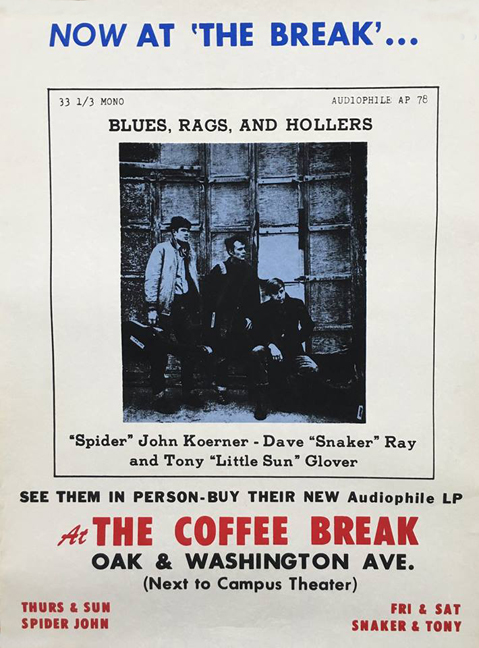
Flier courtesy Paul Pash
When 313 Oak Street SE was wrecked in July 1965, it had a footprint of 20′ by 50′ by 25′. It was a wood frame building with two stories.
A Red Barn fast food restaurant opened in November 1965. Mentions fall off on September 19, 1979.
Other restaurants replaced the Red Barn since.
THE EDGE
In 2011, an apartment complex called the Edge on Oak Street was built where beatniks used to roam. The property has been renumbered 401 Oak St. SE, and belongs to the University of Minnesota.
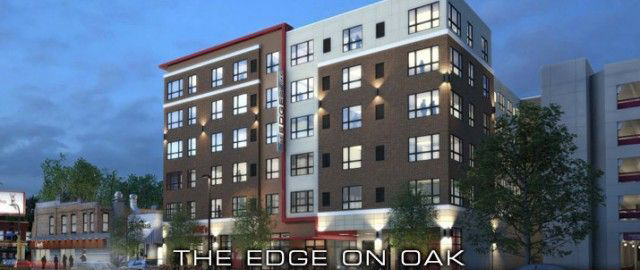
Although no address was given in this ad for the Beanery from the St. Louis Park Sun, one of my readers says it was a part of Lord Fletcher’s in Spring Park. Thanks, Perry!
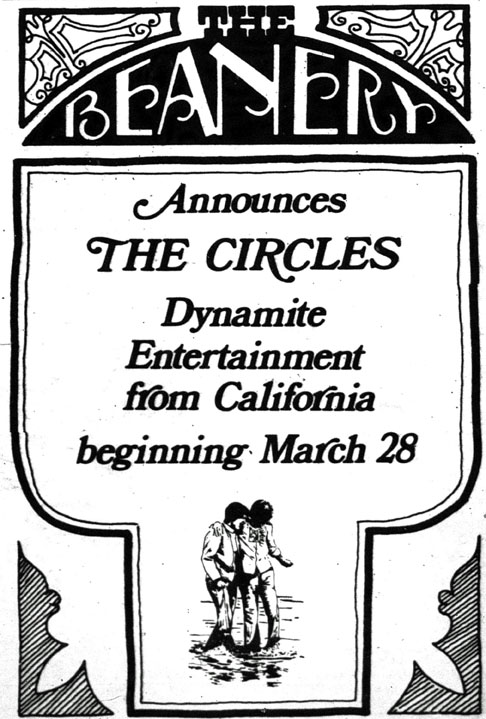
1974
Please see Addison’s Bar and Lounge.
Beek’s Pizza in St. Louis Park had a live combo on Friday and Saturday nights, at least in 1958. There were several other Beek’s Pizzas.
The Bel Rae Ballroom was located at 5394 Edgewood Drive NW (Highway 10) in Mounds View (one mile west of the New Brighton Arsenal). It was sometimes described as being located in Spring Lake Park, and sometimes in New Brighton. On top of that, sometimes Mounds View was spelled as one word, and sometimes correctly as two. It’s a wonder anyone found it!
The Bel Rae was built by:
- Elhart J. Ebel. He booked the bands and handled the business end of the ballroom. He died of emphysema in 1988 at the age of 64. (Minneapolis Star Tribune, December 8, 1988)
- Elhart Ebel’s brother-in-law, Eugene (Bud) Ramacher. Bud was killed in a car accident along with four of his relatives in Wisconsin on August 6, 1990.
- Elhart Ebel’s brother, LaVern Ebel. Sometime before 1970, Elhart and Bud bought out LaVern’s share.
Presumably the name came from Ebel and Ramacher?
In 1971, Elhart Ebel and Bud Ramacher sold the ballroom to Tony Jambor (see below).
The cavernous 18,000 sq. ft. facility offered 3.2 beer, wine, and set-ups; state law prohibited the sale of liquor in dance halls.
According to an article in 1970, Tuesdays had been Teen Nights since the ballroom opened in November 1964. (Minneapolis Star, November 14, 1970) Future star Loni Anderson, a native of Roseville, was a frequent visitor on Teen Nights.
These went by the wayside when the drinking age went down to 18 on June 1, 1973.
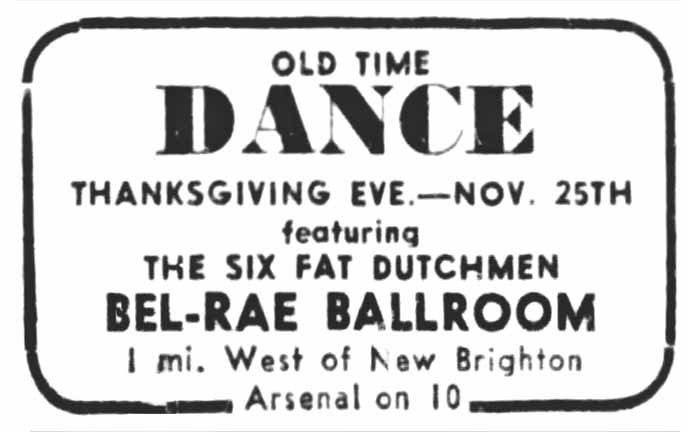
One of the first ads: Minneapolis Star, 1964
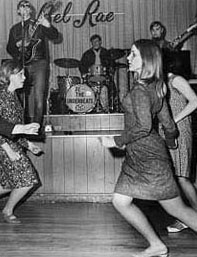
The Underbeats in action
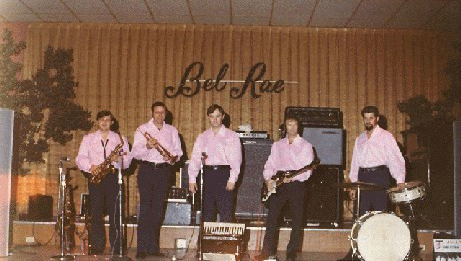
Who are these nice young men in their pink show band shirts?
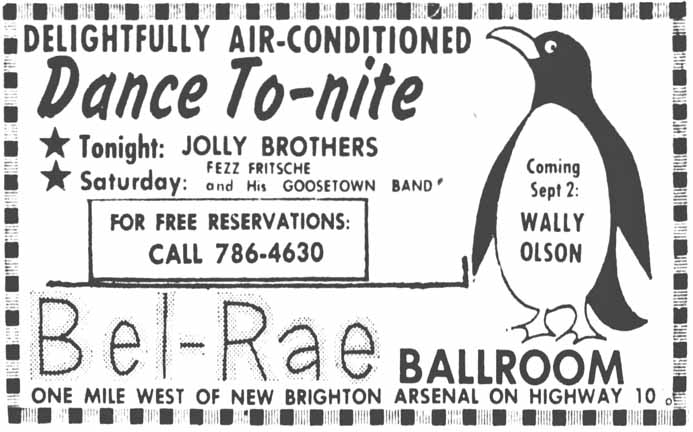
Minneapolis Tribune, August 26, 1966. Air conditioning was important in an era when not everyone had it!
Friday was alphabet night – people with last names starting with letters in that night’s ad got in free.
Another 1967 ad just had polka acts.
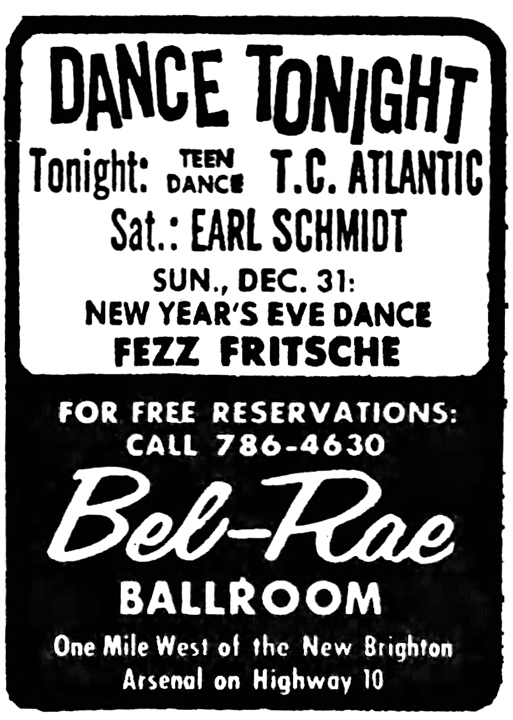
Mpls Star Tribune, December 29, 1967
TONY JAMBOR
In 1971, the Bel Rae was sold to Tony Jambor – in his column Dick Youngblood said for $350,000. (Minneapolis Star and Tribune, March 31, 1985)
Tony Jambor had had his own Polka show on WTCN, Channel 11 TV from 1964 to 1968. Called “Polka Jamboree,” the show was sponsored by Lindahl Olds.
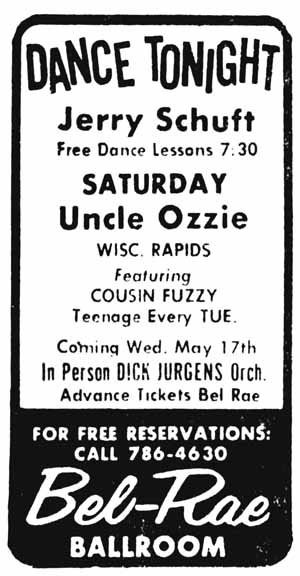
Minneapolis Star, April 28, 1972
Like many other ballrooms, the Bel Rae had “Over 28” nights. The number 28 was chosen so women didn’t have to admit they were over 30! This one was a little late to the game, perhaps because other ballrooms were closing.
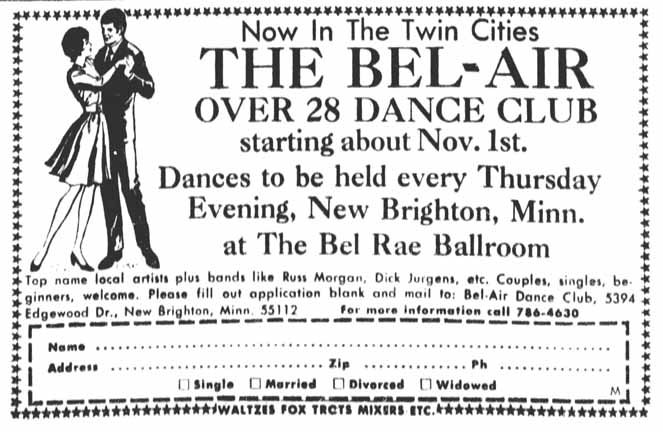
Minneapolis Tribune, October 15, 1972
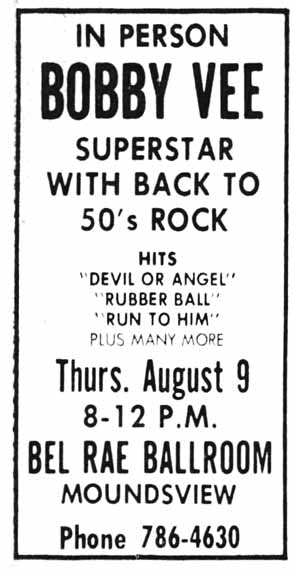
Minneapolis Tribune, 1973
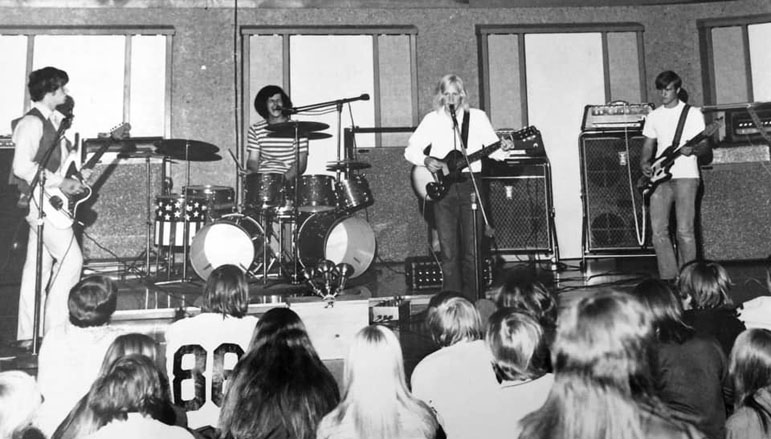
Cain at the Bel Rae, with Jiggs Lee front and Center. Image courtesy Mike Ovik. Approx 1973-1974
A little bit rock ‘n’ roll in May 1974. Floren returned later in 1974 and that time they spelled his name right.
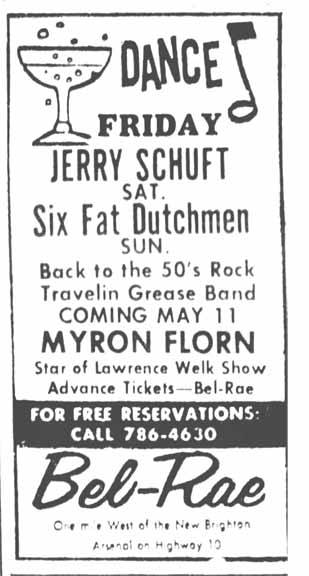
Minneapolis Tribune, Friday, May 3, 1974
Looks like the ballroom was experimenting with different kinds of music to bring their audience numbers up.
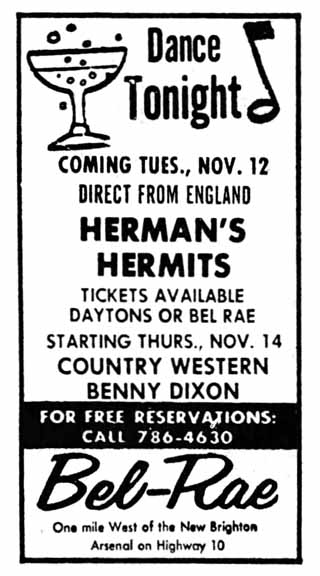
Minneapolis Tribune, 1974
Monkees appeared twice?
1975: Rock acts
1976: Polka Festival, dog show(s), boxing
September 14, 1976: Muddy Waters, Mojo Buford (see ad)
May 12, 1977: Billy “Crash” Craddock (spelled ridiculously wrong), a rockabilly star amidst the polka aficionados.
April 1979: Teen disco every Tuesday, with dance classes
Singles dances
1979: Organized European Tours
1982: Parents Without Partners, Thursdays: Rockin’ Hollywoods: 18 years, Johnny Holm Fun Show, Whitesidewalls
December 16, 1988: Bill Haley’s Comets with Al Rappa on bass.
October 15, 1995: Reunion of performers from the Flame Cafe.
1996: Run by son Butch for last 10 years, but he wanted to become a computer engineer. Nine people died of heart attacks. One man got arrested by the FBI at his own wedding reception. Voting place for all of Mounds View.
June 30, 1996: Last show, Jett Williams
MOUNDS VIEW COMMUNITY CENTER
The building was sold to the city on June 30, 1996, and became the Mounds View Community Center, run by the YMCA.
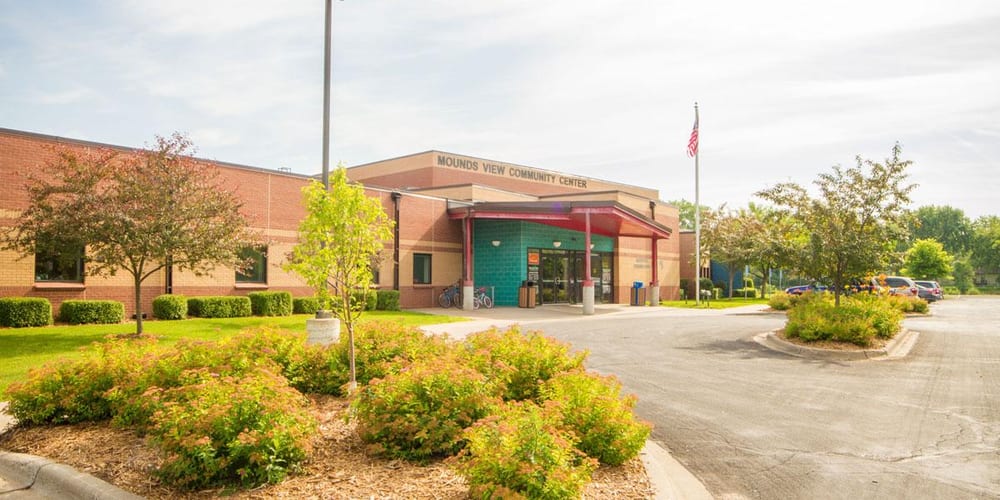
FUN FACEBOOK FACTS
- There is a senior housing complex on County Highway 10 just west of the Mermaid called Bel Rae and I believe the old sign from the Bel Rae has been recycled and is being used on the front of the building!
- When they built the Moundsview Community Center on the site, they kept the dance floor.
- “Quite the In Place to go for a while. Get ready to Rumble in the parking lot! I wonder why we made it this far in one piece!”
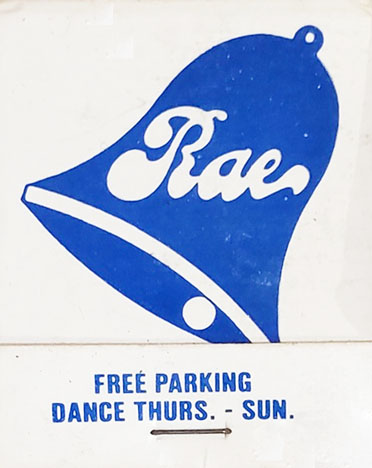
Matchbook image courtesy Janice Bisch
Sixth and Hennepin
The Belmont Club (originally the Bel-Mont) was located at 615 University Ave. (at Dale Street), in St. Paul.
EARLY RESIDENTS
The ad below indicates that 615 University was the home of a White Castle in 1933!
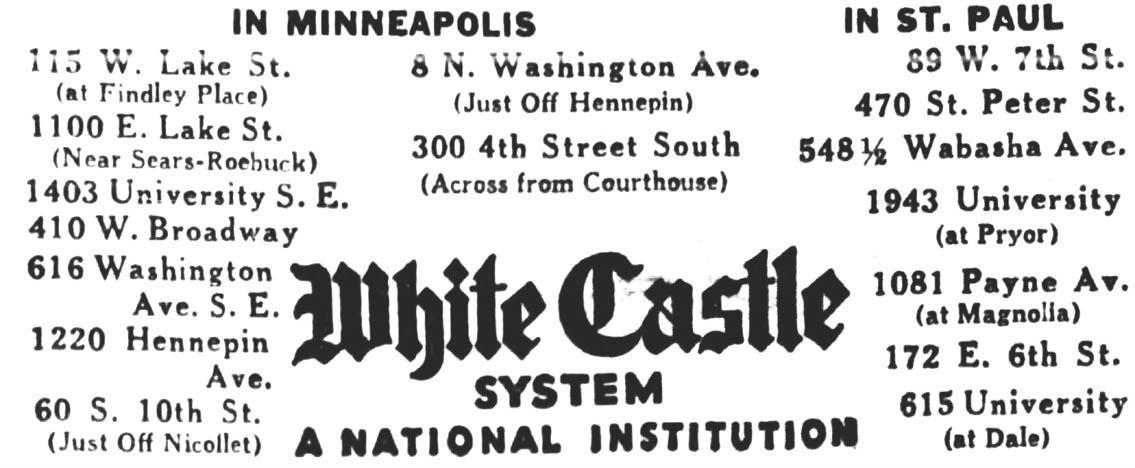
Minneapolis Star, July 20, 1933
THE SILVER STRIPE
In December 1940, a fire burned down a one-story brick building that housed the Silver Stripe Bar and Restaurant.
THE BEL-MONT
One article says that the Bel-Mont was named for the first two owners, Henry Belisle (a relative) and Earl Montpetit.
Brothers Earl and Walter Montpetit bought the club in 1950.
Earl lost the liquor license because of a Federal conviction in 1959.
New management leased the bar from the Montpetit’s sisters. (Minneapolis Star, November 16, 1961)
THE BELMONT SUPPER CLUB
It reopened as the Belmont Supper Club in about 1962. In January 1963 it closed for lack of payment of rent.
In February 1963 the license was again transferred, to Clayton Montpetit, yet another sibling of Earl. In return he had to pay back rent, pay for the transfer of the license, and bar Earl and Walter from hanging out there. (Minneapolis Star, February 15, 1963)
THE BEETLES!
In February 1964, a group called the Beetles (formerly the Tornadoes) started a stint at the Belmont, reported Will Jones in the Tribune. Jones covered this phenomenon extensively, observing that the place was packed, even with a $2 cover charge, and noting that the boys did a polka set.
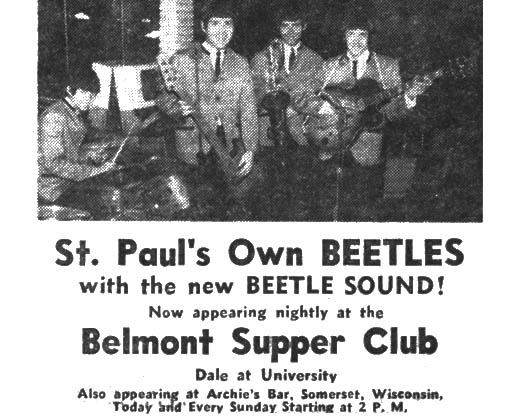
Ad courtesy Beetle Jack Doepke
GIRLS IN CAGES
In 1966 the bar featured Og-Og… I mean Go-Go Girls in cages, like on “Shindig.”
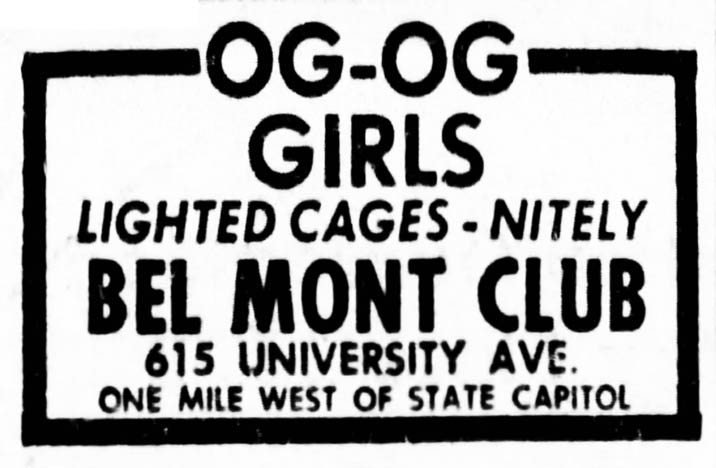
Minneapolis Tribune, August 25, 1966
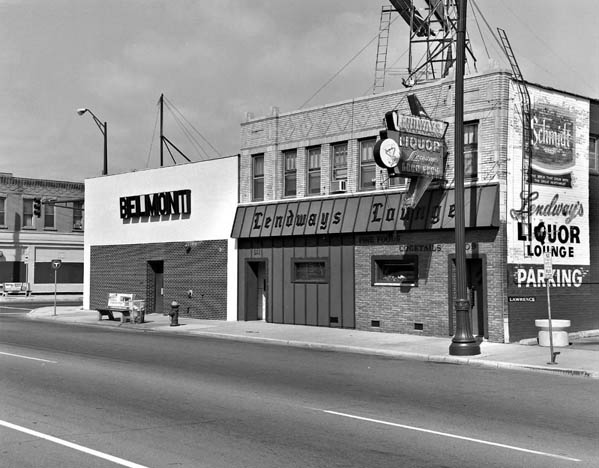
Belmont Club, 1967
An article from December 1967 describes the bar as the Clayton Club, formerly the Belmont Club. (Minneapolis Star, December 27, 1967) But that didn’t hold, since ads for the Belmont appear in January 1968.
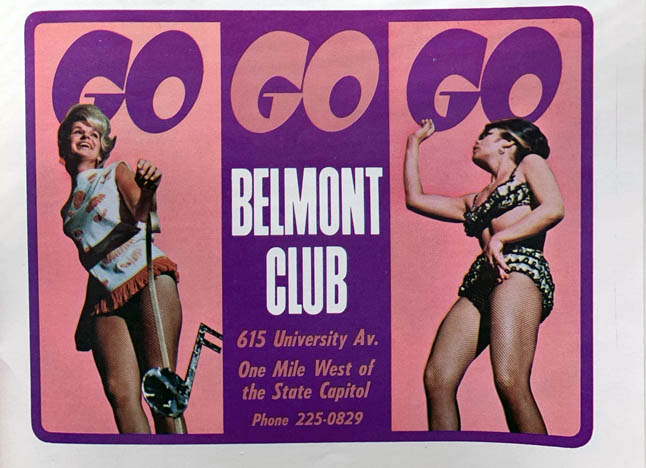
This image is probably from about 1968.
In June 1969 the club started a new policy, featuring some of the biggest bands in town.
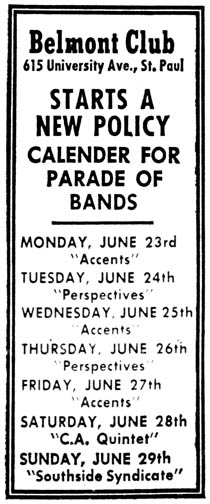
Minneapolis Tribune, June 22, 1969
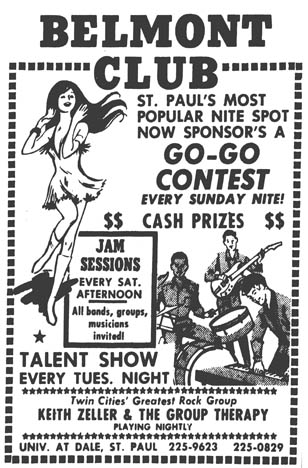
Minneapolis Star, January 15, 1971
MURDER
On January 10, 1973, a janitor at the club was tied up and beaten in the basement of the club. A week later he was found dead in the laundry room of his apartment building. (Minneapolis Tribune, January 19, 1973)
In February 1973 there was an ad saying that the Belmont was Back in Action; begs the question as to whether the club had closed for a while.
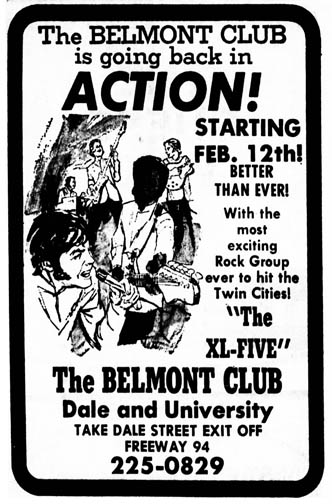
Minneapolis Tribune
In March 1973 classifieds advertised for go-go dancers.
THEY CALL IT THE STREAK
In keeping with the biggest fad of 1974, “Streaking” was advertised at the Belmont, although it was probably an excuse to introduce nude women into the mix.
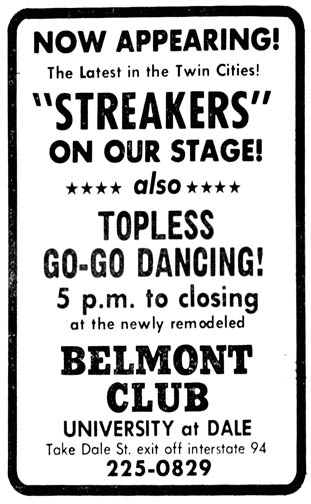
Minneapolis Tribune, April 28, 1974
CLOTHING OPTIONAL
By November 1974 the place appeared to be less participatory and more observatory…
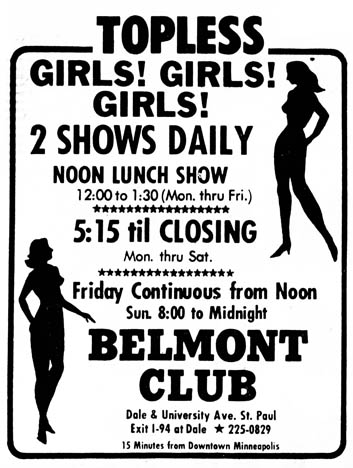
Minneapolis Star, November 7, 1974
GIRLS IN CAGES II
In January 1979 the manager was George Montpetit. Nude women danced in glass-enclosed cages to get around the city’s ordinance against nude dancing in bars.
In 1984 Walter Montpetit sold the building to Maurice Fung for $350,000.
STUNG
In February 1988, Walter Montpetit was arrested in a sting operation. He had “owned the Belmont Club for years.” (Minneapolis Star Tribune, February 13, 1988)
TOO YOUNG
On February 8, 1988, David Fan, the manager of the club, was charged with hiring a 13-year-old nude dancer. The girl was a runaway from Menomonie, Wisconsin, and was arrested that night.
After an investigation, the St. Paul City Council voted to revoke the club’s liquor license. Fan was also charged with a felony for hiring a minor for a sexual performance and went to trial in Ramsey County. He was found guilty and sentenced to 30 days in the Workhouse and five years probation.
On top of everything else, on November 28, 1988, the bar was raided by Federal agents as a result of a three-year investigation into irregularities into the reporting of wages of dancers by Fan’s subsidiary, Dancing Angels, Inc.
The last dance at the Belmont was November 30, 1988, as part of an agreement with the City that Fan would sell the Belmont and his share of the 7th Street Trolley, another nude dancing place in St. Paul.
In April 1989, the City of St. Paul offered to buy the building for $315,000 and turn it into a police station.
In 1989, Montpetit sued David Fan, the manager of the club, for $260,000 for nonpayment of the mortgage since July 1988.
BLUE CLOTHING REQUIRED
After spending $675,000 to purchase and renovate the property, it became a police precinct headquarters on August 31, 1990.
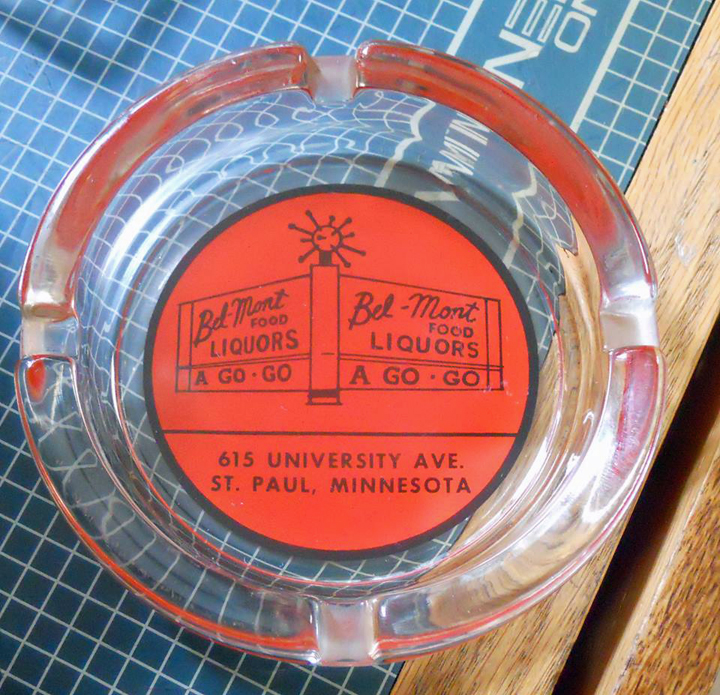
From the collection of Mark Youngblood
Bibeau’s Tavern was located at 624 Wabasha Street in St. Paul.
This 3.2 beer tavern comes to our attention from a picture posted on Facebook by Kimberley Lambert in 2022. It is a photo of her Great Aunt, Eva Cates, standing in front of the building, which clearly has those magic words “Dine – Dance” on the windows.
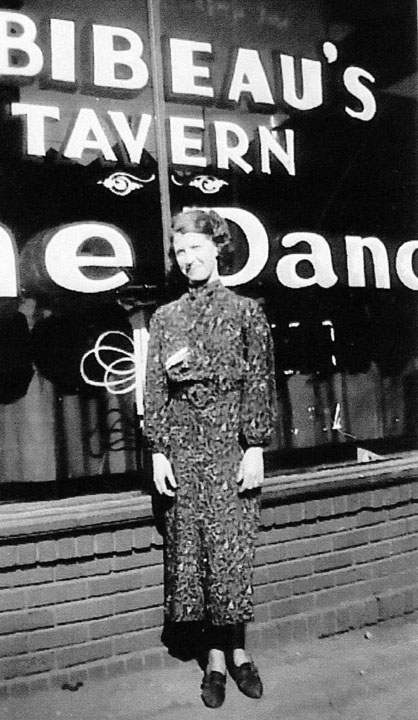
Image of Eva Cates courtesy Kimberley Lambert
Because the venue was in St. Paul and those newspapers are not online, there is not much to know about it. And unfortunately, as usual, what there is to know comes from crime reports.
The first was in 1937, when a robber threw bricks through the window, knocking one employee unconscious. The villain then helped himself to $300, the day’s receipts, while three others in the place, including Bibeau, had to lay on the floor. The headline? “‘Brick’ Bandit Cows 4 in Raid.” (Minneapolis Star, November 15, 1937)
In 1939, the tavern was raided by police and 11 people were arrested in a so-called “anti-Fagin” drive. This referred to underage kids who were taught to be criminals by older ex-cons on the streets, as in the Fagin character in the book Oliver Twist. Arrests were made for gambling, selling liquor without a license, vagrancy, and vice. (Minneapolis Star, February 13, 1939)
The location of the tavern is lost underneath Interstate 94.
JAMES JOSEPH BIBEAU
James Bibeau was born on September 1, 1901. In 1930 he lived with his wife Mabel in White Bear Lake and worked as a driver for a laundry company. The tavern may have started up soon after Prohibition ended in April 1933.
The 1939 raid most likely spelled the end to Mr. Bibeau’s 3.2 beer license and explains why he was back to driving for the laundry company in 1940. In 1942 he completed his World War II registration card, indicating he worked for the Model Laundry Company. He was 40 years old, and only 5 ft. 3 1/2 inches tall, so he wasn’t a good candidate for the military. He and Mabel’s children were Russell, Willard, Richard, and Dolores. James Bibeau died on January 10, 1966.
More to come on this!
The building at 1229 So. 5th Street in Minneapolis housed various music venues, including:
- Town Hall Cafe
- Peggy’s Bar-B-Que
- Big Al’s Jazz Club
In an article by Allan Holbert from the Minneapolis Tribune (October 6, 1968), we find that that the building, just feet from the Milwaukee Road the railroad tracks, was originally a “hotel and restaurant catering mostly to railroad men.”
TOWN HALL CAFE
The Town Hall Cafe opened at this address in the summer of 1937. Entertainers in August 1937: Arthur Bell (Twin Cities), and Iola (New York). In October 1937 the new manager was Hobart T. Mitchell. In November 1937 it was redecorated in white and maroon with red tapestry and oil paintings.
PEGGY’S BAR-B-Q
“For Food That Is Out of This World.” In 1948 the proprietor was Neil Berman. The undated Tribune article said that Peggy’s had “a cigarette machine that dispensed booze by the pint instead of tobacco.”
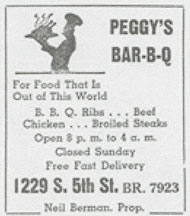
1948
Again quoting Holbert, “For a year or so, in the late ’50s, it was a fag joint.”
BIG DADDY’S
At some point in about 1956 – ’57 it was Big Daddy’s jazz venue.
BIG AL’S
In 1961 it became Big Al’s. Did someone say that Big Al was a chicken sexer? Big Al was Alan Robert Cohen, and he was bigger than the picture on the building, says his son!
In 1964 there were jazz groups upstairs and downstairs. To get upstairs patrons had to climb a rickety fire escape. In 1964 they also instituted “Blue Monday” jam sessions during the day on Mondays.
In 1967 it was owned by Lloyd Beck and the Dave Rooney Trio. The 1967 ads say “Where it’s Always Swingin.'”
The building was decorated with cartoons.
Holbert noted that the “smoky, second-floor piano lounge” was the haven of “married men with their girlfriends and no one said anything. It was a joint where black and white people mixed on the stage as well as at the little white tables and there were never any fights or problems. The police never had to hang around. There would be a hooker there every now and then, but she would usually be there with her pimp and they were there to enjoy the jazz, not to hustle. It was the kind of a place that tourists would have liked, but they didn’t know about it because it was off the avenue.”
I’m sorry, I don’t know where these photos came from, but they are remarkable!
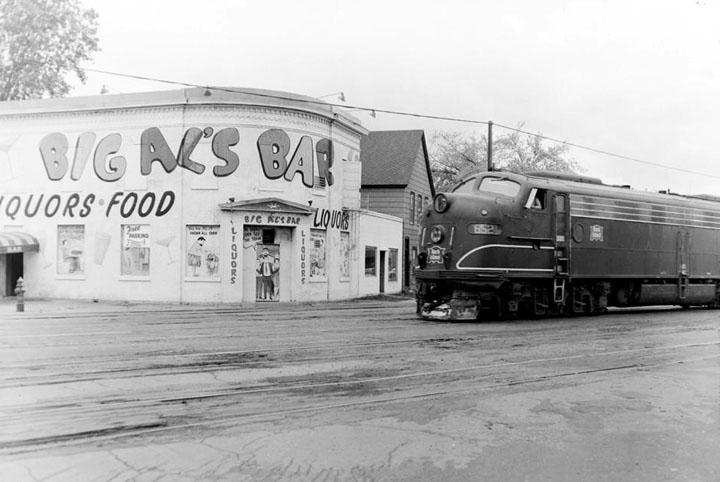
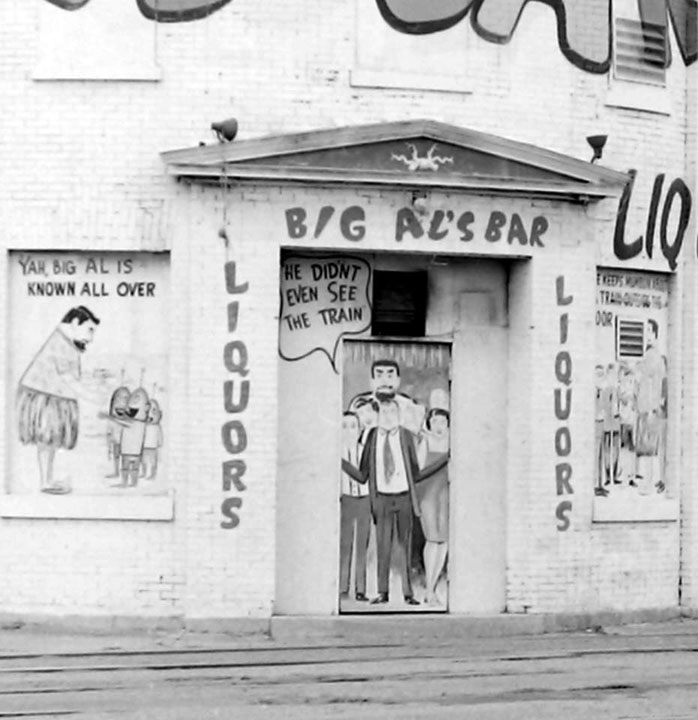
In 1959, Big Al and partners became owners of the Gay ’90s and the Happy Hour in Downtown Minneapolis.
In about 1968 the building was demolished to make way for 35W.
I saw ads for this place from December 1932 to 1937, and just loved them! Who would start a bar before Prohibition was over? An optimist, I guess. And name it the Big House? (Did the waiters wear stripes?) The answer is a guy named Frank Potvin, whose name was associated with a big moonshine seizure in 1920 but got a liquor license anyway.
The address was 1329 So. 3rd Street, which, as far as I can make out, is where 35W meets Washington Ave. Maybe he had a big house.
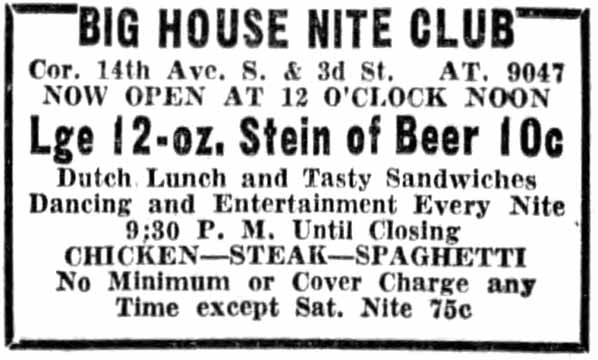
Minneapolis Star, May 19, 1933
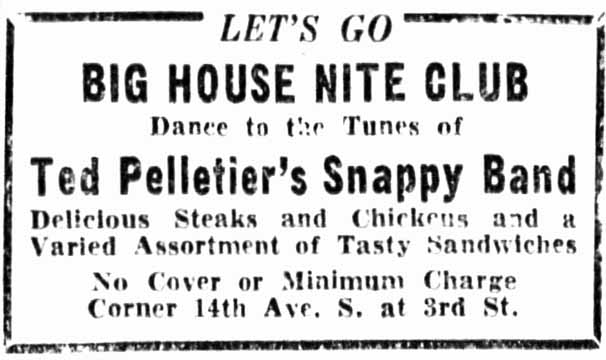
Minneapolis Star, September 1, 1933
Big Island Park operated from 1906 to 1911. This 65-acre park was situated on the heavily wooded Big Island on Lake Minnetonka.
It was purchased in 1905 and operated by the Minneapolis and Suburban Railroad Co., a subsidiary of the Twin Cities Rapid Transit Co. (TCRT). Park-goers would take the new electric streetcar, which ran just south of St. Louis Park on 44th Street, to the Excelsior Dock, where passengers could take one of nine streetcar boats (named Minneapolis, St. Paul, Minnetonka, Como, Minnehaha, White Bear, Hopkins, Harriet and Stillwater) to the Park. The official opening was on August 5, 1906. The boats operated until 1926.

Big Island Music Hall, 1906. Photo Courtesy Minnesota Historical Society
Patrons were met with such amusements as the “Happy Hooligan Slide,” a “Figure-8 Toboggan,” and a miniature train. The Park featured a large music casino, a large roller coaster, the Old Mill, the Scenic Ride to Yellowstone, and a carousel. The buildings has a Spanish mission theme. A 200 ft. tower dominated the park.
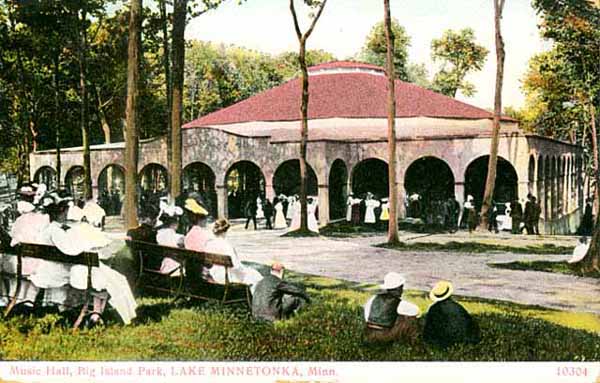
Big Island Music Hall, 1908. Photo Courtesy Minnesota Historical Society
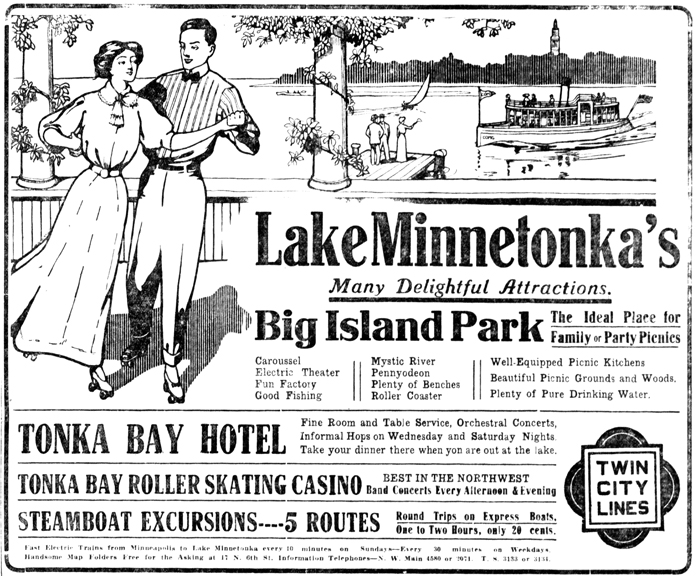
Minneapolis Journal, July 18, 1909
The price was only 25 cents, including the streetcar ride, and it became clear that it was not a profitable operation, especially after the TCRT also bought the Tonka Bay Hotel. Both the Park and the Hotel closed at the end of the 1911 season. After sitting abandoned for a few years, the Park was disassembled in 1918, its iron going to scrap iron for the WWI War effort. Some remaining buildings, including a mess hall, became part of a Veteran’s Camp starting in the early 1920s.
The streetcar boats were discontinued in July 1926. In 1925, Excelsior Amusement Park was built at the site of the waiting station for the streetcar boats. Streetcar boats were revived in 1996.
U of M Campus
The Bijou Theater was located at 20 Washington Ave. No.
It was originally called the People’s Theater, designed by architect Harry G. Carter. It opened on October 31, 1887, and was owned by Kohn and Middleton.
In July 1889 the People’s was taken over by Jacob Litt, who renamed it the Bijou Opera House.
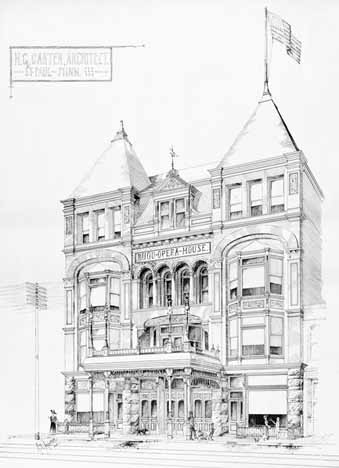
Bijou Opera House, 1890. Minnesota Historical Society
The theater burned to the ground in December 28, 1890, when a gas jet behind the scenes got too close.
A second, slightly larger Bijou Opera House was built on the same site in 1891, again to the plans of architect Harry G. Carter. In the meantime, Bijou attractions were housed at the Lyceum. The Bijou had started out strong presenting melodrama, but that had died out, so it adapted to movies.
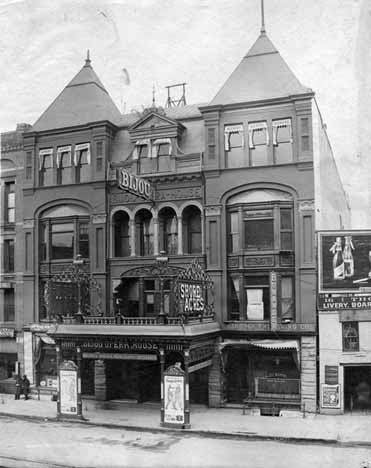
Bijou Theater, 1897. Courtesy Minnesota Historical Society
A stock company in later years brought in an “uptown crowd” for one season while it was temporarily called the Bainbridge.
The interior of the Bijou Theatre was remodeled by architectural firm Liebenberg & Kaplan in 1927 and again around 1931-1933.
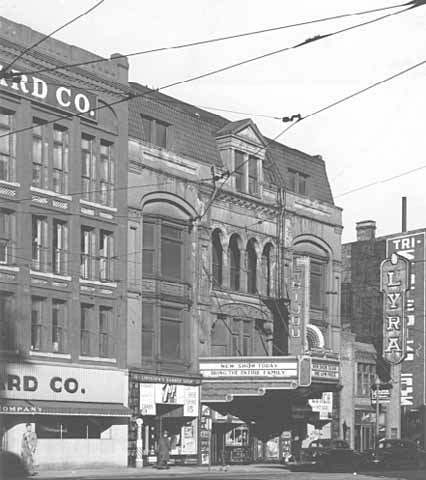
Bijou Theater, 1948. Photo Minnesota Historical Society
The Bijou Theatre was still open in August 1959, and it closed soon after. It was demolished in 1960.
Sources: Edgar, cinematreasures.org
County Road 15 (4000 Shoreline Drive) in Spring Lake Park. Opened May 1966 (ad below from Minnetonka Record). 1967: “Sing-along and dance-along to the Bruce Leland Trio.” Still there in 1971.
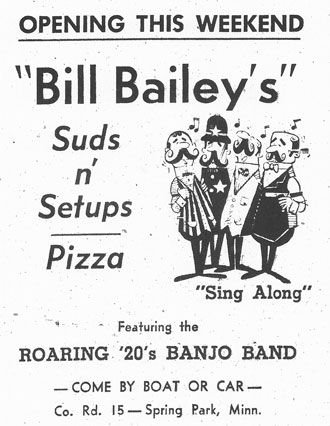
All we know about this place is that it was 1-1/2 miles east of Excelsior Village on Excelsior Blvd.
VINE HILL CAFE
The name suggests that this was at the intersection of Excelsior Blvd. and Vine Hill Road. This was in the 1920s, before Highway 7 was built.
BILL’S INN
In about May 1926, William L. Millington of Minneapolis bought the Vine Hill Cafe. Bill had previously been in real estate. In October 1926 he added a Benzo gas station.
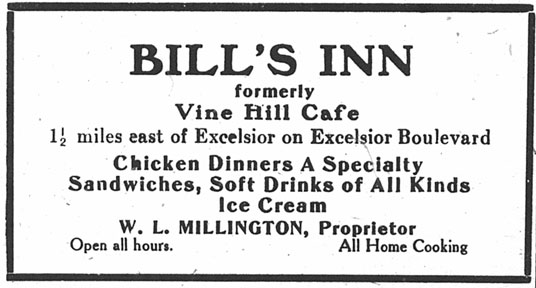
May 21, 1926
This was possibly a “chicken shack” so prevalent during Prohibition; an excuse for a set-up place? Local resident Lee Blaske sheds a little light:
Lee also provides these clues:
NOT TINO’S
I had the feeling that this is the building at 19215 Highway 7 in Shorewood. Hennepin County dates it at 1966, but it has tin ceilings and old wood floors. Lee Blaske set me straight on that:
Bill’s Place was a tavern located at 5410 Wayzata Blvd in Golden Valley. It was at Turner’s Crossroad, one mile west of the Minneapolis border.
It was once Pete Faber’s from at least December 1937.
It opened as Bill’s Place on August 3, 1938. It offered “Entertainment, dancing, and foods.” In September 1938 it advertised for a 3 piece union orchestra.
Bill was William J. Schindler, who went on to own the Boulevard. A relative describes him as a real estate investor who moved around a lot.
In 1939, an ad promised Dancing and An Enjoyable Time. Nice menu: Bar-B-Q-Ribs, Chow Mein, Home Made Chili, Hot Tamales, and Glueks on Draft!
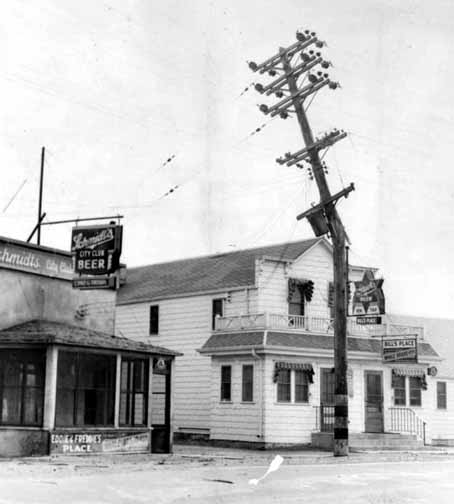
Bill’s Place (on right), 1939; photo courtesy Hennepin County Library
In October 1940, the Tribune noted that police switchboard operator John Barber lead the orchestra at Bill’s Place “on Superior Blvd.” – the old name of Wayzata Blvd.
Bill’s Place lasted until at least January 1, 1942.
Bill’s Roller Rink was somewhere in Anoka.
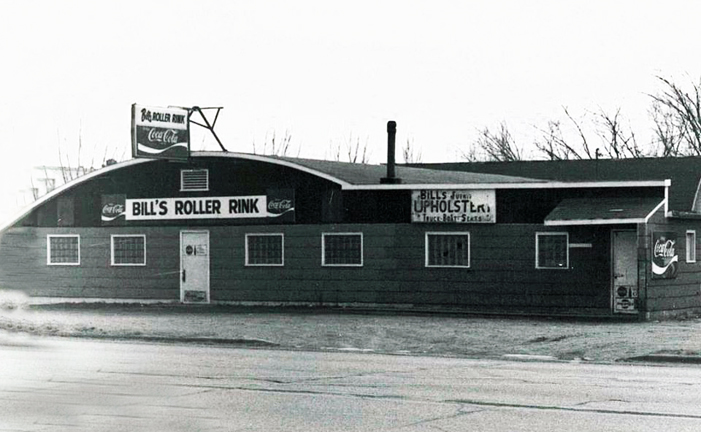
Photo of Bill’s courtesy Stephen Michael Swenson, Sr.
The photo below is from the annals of Facebook. How often did musicians fall off their tiny stages?
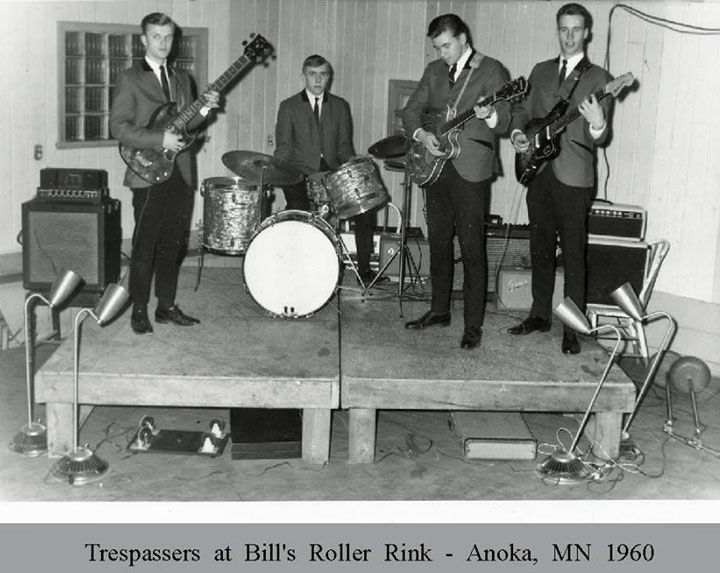
1301 Washington Ave. No. at Plymouth. Country bar in 1973-74, with house band Freddie Haas and his Golden Nuggets.
Bimbo’s was located at 243 Cedar Ave., on the West Bank, Minneapolis. Tracing the history of a building where several addresses are involved is difficult, but I’ll give it a try.
SOUTH SIDE HOTEL
According to the permit card, three frame buildings were built in this location starting in 1901, but were demolished in March 1910. One of those demolished dwellings appears to be the South Side Hotel and an attached cafe, which continued in the building that replaced the three until about 1915.
FURNITURE FIRST
This venerable old brick building was built in 1910 as a store and rooming house. 239-245 Cedar was the home of the Bolmgren Bros. Furniture Company. In October 1934, a tube of teargas in the vault foiled a burglary attempt, but the persistent yeggs, as they were called, came back with gas masks and finished the deed. The next month the company put their upscale inventory up for final sale, remodeled, and in March 1935 reopened as a “Wage Earners” Furniture Bargain Mart.” In 1938 the store was renamed Nordtvedt Bolmgren for its two partners. The last ad was in June 1951, and the building was listed for rent the next month.
After being advertised for sale for a long time, the building was used by Underwriters Salvage Company for auctions from 1955 to 1964.
239 CEDAR FIRE
Although the building was referred to as 239-245 or 239-243 Cedar, there were apparently separate buildings involved. On March 18, 1959, fire broke through the ceiling of the two-story building at 239-41 Cedar. This building housed the Club House Bar on the ground floor and 17 single room occupancy apartments above. Four died and eleven people suffered from smoke inhalation – they were mostly elderly. That building was demolished. Next to it was a vacant lot where another hotel had burned eight years earlier, killing four people.
BIMBO’S NOW OPEN
Bimbo’s Pizza Emporium and Ole Time Saloon opened in December 1966 as a beer and pizza place with a gaslight-era decor, according to Will Jones. Doc Evans opened the place with his banjo, and the management was clearly looking for and older crowd by offering sing-a-longs.
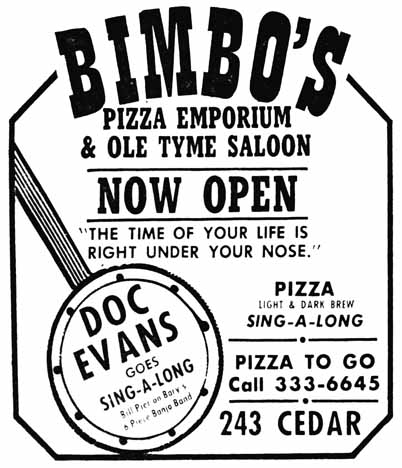
Minneapolis Star, December 16, 1966
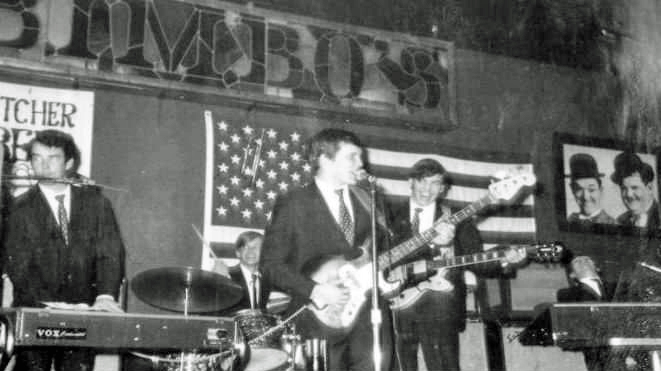
The Castaways at Bimbo’s, 1966 – photo courtesy Tom Husting. Greg Maland, Dennis Craswell, Roy Hensley, Tom Husting, and Dennis Libby
Subsequent ads continued the sing-a-long trend, “In the Big Band Tradition,” and the banjo stylings of Marv Ludwig.
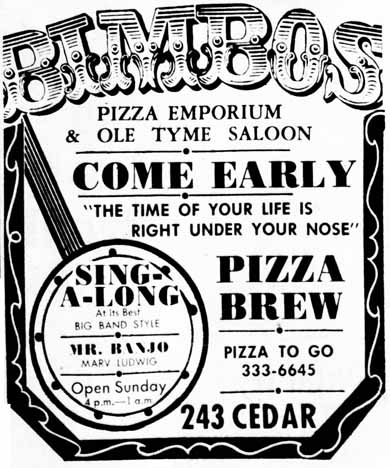
Minneapolis Tribune, January 7, 1967
ROCK PREVAILS
Well, Marv wasn’t bringing in the kids in 1967, and the music quickly turned to rock., making the switch that February.
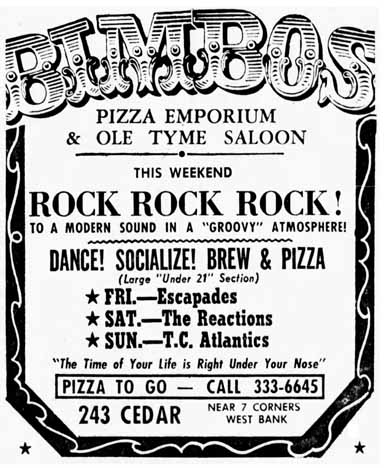
Minneapolis Tribune, February 17, 1967
Old time movies were shown on Monday nights. A special section was available (no beer) for teens to dance.
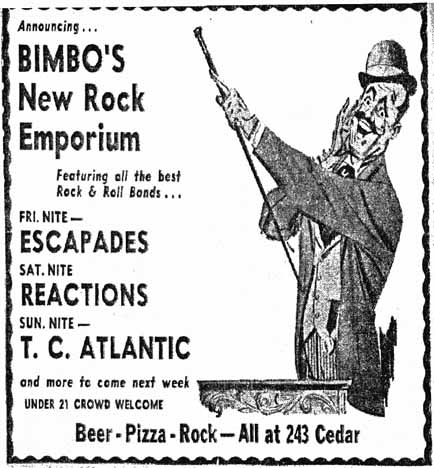
Minnesota Daily, February 17, 1967. Ad courtesy Robb Henry
Apparently the name had changed, too. The ad below calls it Bimbo’s Rock Emporium.
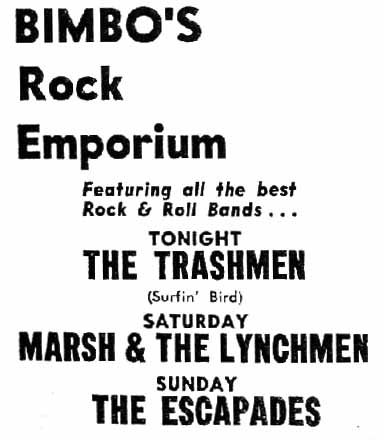
Minnesota Daily, April 9, 1967. Ad courtesy Robb Henry
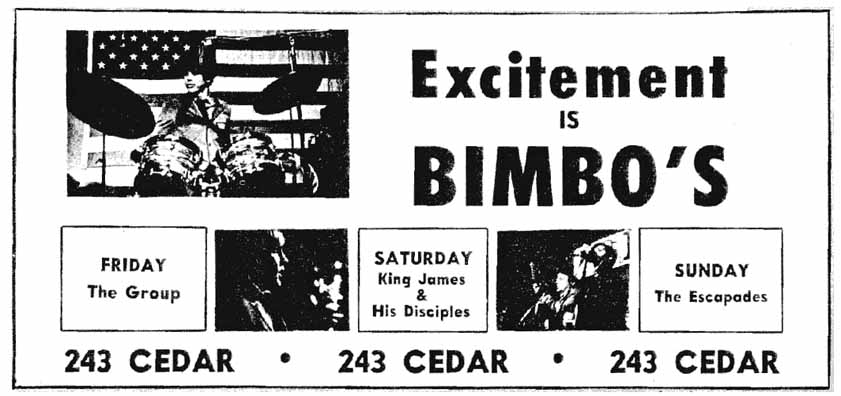
Minnesota Daily, May 26, 1967. Ad courtesy Robb Henry
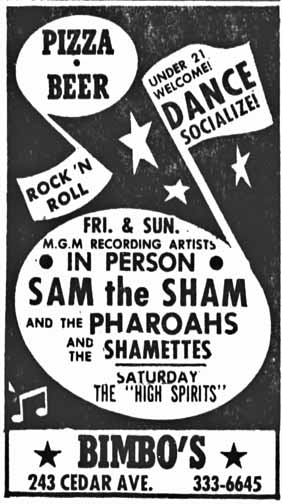
October 13, 1967, Minneapolis Star
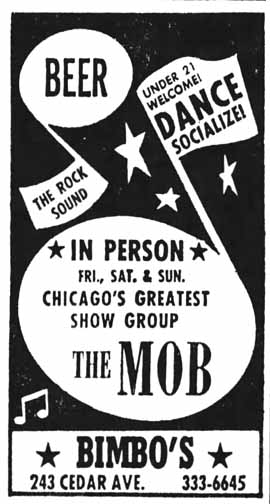
February 9, 1968, Minneapolis Star
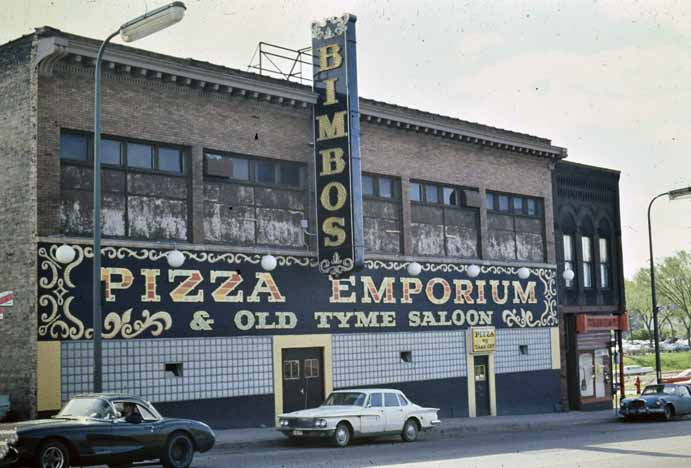
Photo courtesy Hennepin County Library
FIRE DOWNS BIMBO’S
On April 15, 1968, there was a three-alarm fire that started in a trash can in an employee bathroom in the basement. It burned through to the first floor in two places and caused $15,000 in damage. There was an arson investigation, but no result was found in the paper. (Minneapolis Star, April 15, 1968)
The club never recovered, and it sat boarded up for a year. In his music column, Allen Holbert identified the owner as Ted Vuich, age 28, who owned six other clubs in college towns across the country. (Minneapolis Tribune, June 2, 1968)
By March 1969, the property was identified as belonging to the Cedar-Riverside Associates, Inc., guided by Gloria Segal. A deal was struck to sell it to Theater in the Round, which had lost its lease. (Minneapolis Tribune, March 28, 1969)
The Black Angus was located at 1029 Marquette Ave. in Minneapolis.
The restaurant was established in 1962 by Harold “Butch” Brambilla and Nate Shapiro to replace the Nelson Cafe and Bar and the Lipstick Lounge. (Minneapolis Tribune, August 8, 1982)
It had a piano bar that became a disco before its time.
Will Jones, entertainment columnist for the Minneapolis Tribune, is hilarious. In May 1963 he told a long story about how the Musicians’ Union was giving clubs a hard time, and in response many were pulling their live music and bringing in:
that Parisiann phenomenon, the all-record night club. There’s already a modified version of it in the Lipstick Lounge at the rear of the Black Angus restaurant. After pianist Joe DeMarsh was given his notice in the middle of the hassle with the musicians, the Lipstick Lounge took out its piano and installed a hi-fi record player in the piano bar, with a girl disc jockey behind it..
The girl in charge of records is Kay Clark Nygaard, who for disc-jockey purposes is being billed as K.C. Nygaard. The curvy Mrs. Nygaard is a bit of a kook with a big toothy smile and a pair of Ben Franklin glasses that tend to slide down her nose. She was three hours late for work on her opening night because she had trouble selecting just the right dress… The requests ran to Brubeck and Jamal and Kenton the night I visited the Lounge. Sometimes Mrs. Nygaard vocalized along with a record, and once she stood on the bar and twisted, but mostly she just sat smiling and wiggling and making sly little comments to the customers..
Sue Earle performed nightly in 1969. Thanks to whoever posted these images on Facebook!
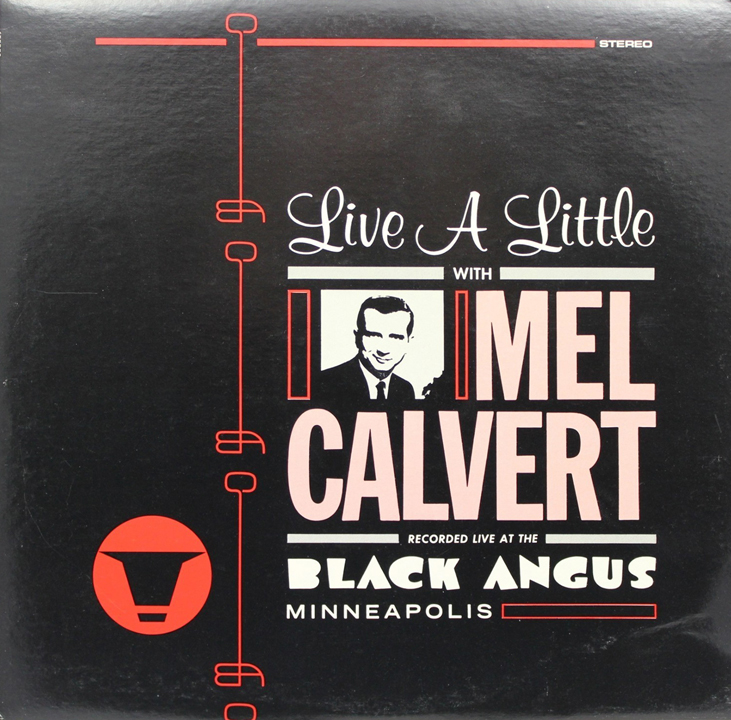
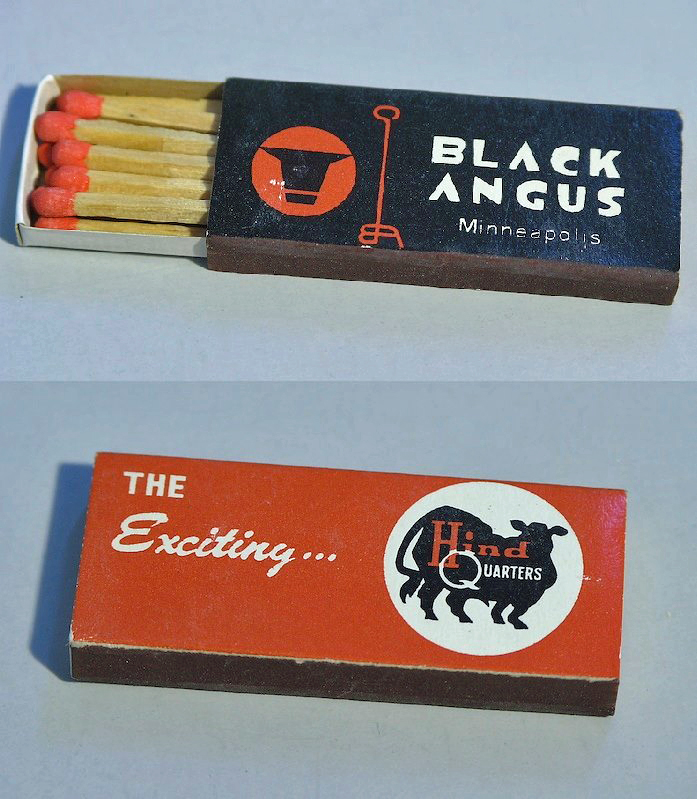
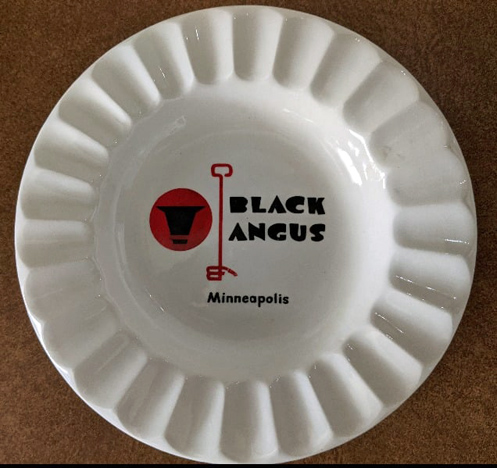
Ashtray posted on Facebook by Kevin Flagstad
The Black Angus closed on August 7, 1982. When it closed, the Minneapolis Tribune gave the Manager’s name as Ron Dougherty, and the owner as Bob Short.
Save
The Black Cat was a legendary night club located on the corner of Bloomington Road and Cedar Ave. in Bloomington. Those roads became Old Shakopee Road and Old Cedar Ave., and its address became 9139 Cedar.
Stan Danielson explains that this was originally a house on the SW corner of the intersection for some years before Jeremiah Scott bought it in the early 1900s and moved it to the NE corner. He called this intersection, “Long Meadow.”
The photo below shows a precursor to the Black Cat – Scott’s Long Meadow, where you could get Minnehaha Pale. This near beer was made by the Golden Grain Juice Company, and was a malt beverage with no more than 0.5 percent of alcohol. The photo has been tentatively dated to 1915-1916, which was before Prohibition, but Bloomington may have been dry at the time.
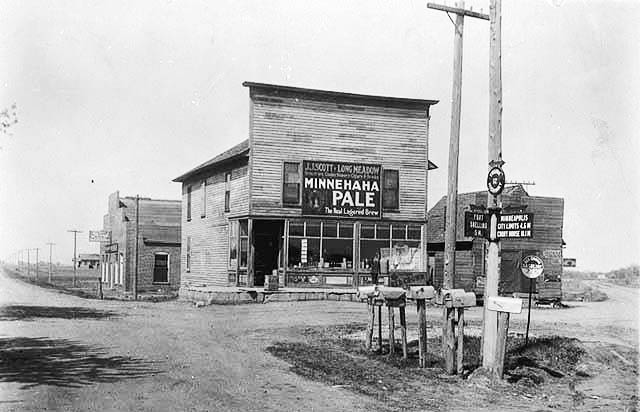
Photo courtesy Minnesota Historical Society
To the left of the building in the photo above was Scott Ford, a car dealership that dates back to the early 1900s. According to Greg Rohlen, that building still stands on the east side of Cedar at 91stStreet.
Based on the photo above, Kirk Brust created the painting below in the late 1990s. He sold the painting, but kept a photo of it to share on Facebook, and has given me permission to post it here. Thanks, Kirk!
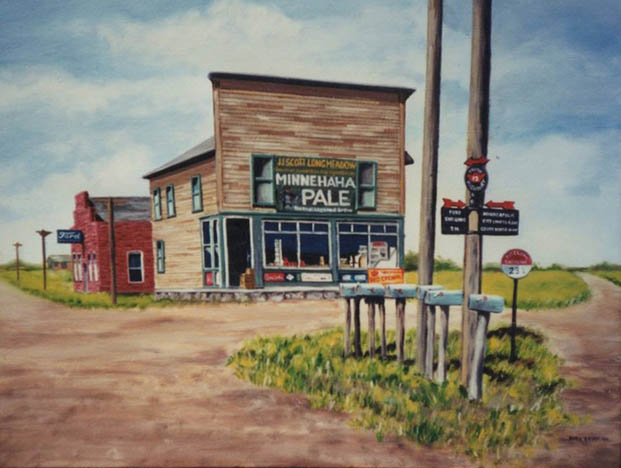
Courtesy of Kirk Brust
THE BLACK CAT
If anything, the owners were good at publicity! I have a LOT of ads to post here, so bear with me.
Here is what appears to be the second ad in the Minneapolis newspapers. It promised paved roads from town, room for 250 cars, the music of George Barton and his “peppy” Chat Noir (French for Black Cat) Orchestra.
Fine food was prepared by Adolph Berger, a man who was obviously German but who had been cheffing here in Minnesota safely since 1913, before World War I. 1929 was still during Prohibition, but out in the sticks of rural Bloomington, all bets were probably off, and that Near Beer was no doubt a thing of the past.
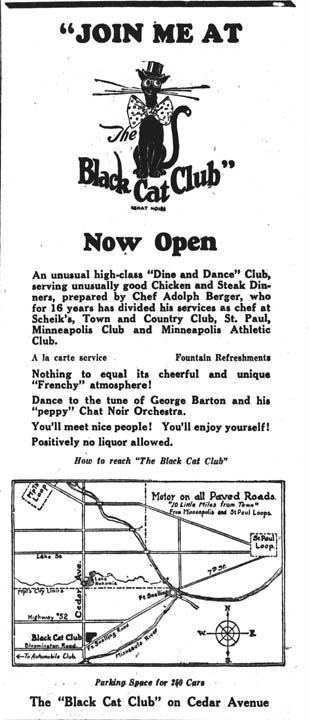
July 20, 1929
The Black Cat looks like he’s dancing and having a good time!
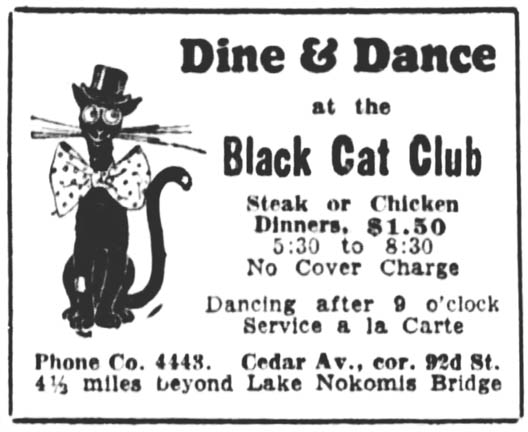
Minneapolis Star, August 15, 1929
Music by Bill Moore and his Nine Dixie Playmates. Moore was extremely popular in the 1920s and ’30s, with an ever-changing lineup of musicians. The cat looks a little more threatening – or threatened.
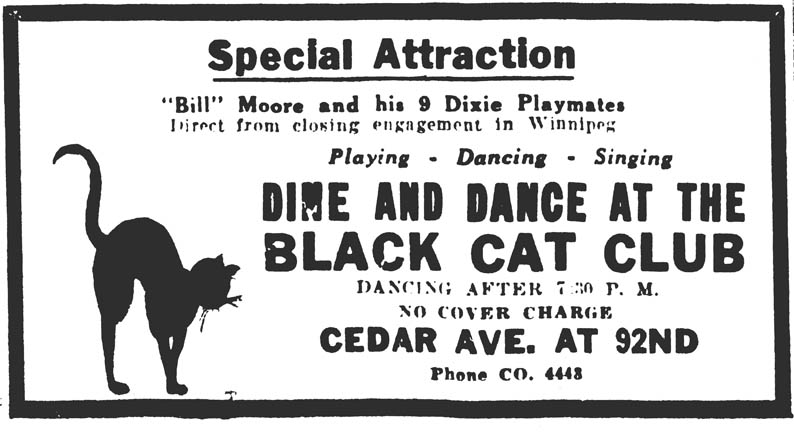
By November 1929, radio station WDGY was broadcasting the Black Cat Club Orchestra from 6 to 6:45 pm. Another program was the “Whoopie!” Club.
In 1930, WCCO Radio did a broadcast that simulated a visit to the Chat Noire, a Paris nightclub that dates back to 1881. French songs would be sung at the Black Cat, if I’m reading this right, over a series of programs. (Minneapolis Tribune, February 16, 1930)
CEDAR CREST
At approximately June 2, 1930, the name of the establishment became Cedar Crest. The house band continued to be broadcast over WDGY as the Cedar Crest Orchestra. The manager was J.B. Waite.
On August 23, 1930, Waite was arrested in a raid that found 15 couples still dancing after the midnight curfew. No dancing on Sunday! (Minneapolis Star, August 25, 1930) Waite was convicted and fined $25, but argued that his was a night club and not a public dance hall, and would appeal.
On June 11, 1932, Art Bowee, identified as the operator of the Cedar Crest, was arrested for allowing dancing after midnight on a Saturday night. He plead not guilty. (Minneapolis Star, June 15, 1932) On August 25, the Tribune identified said proprietor as Arthur Bubee, and said that the $100 fine levied upon him for allowing five couples to dance after midnight had been dismissed upon appeal, because the couples had not paid anything to dance.
On September 24, 1933, the Cedar Crest was advertised for sale. It also had “five modern living-rooms on second floor.”
The last ad found for the Cedar Crest was December 30, 1933.
FLYING HOME
At the time the Black Cat was established at the turn of the 20th Century, there were plenty of open spaces in the nascent Bloomington, enough for a small private flying field at 87th and Cedar. Pilots and their passengers would take advantage of the remoteness of the place and indulge in activities that were more closely watched in the Twin Cities of Minneapolis and St. Paul.
Instead of Near Beer, patrons could get 3.2 beer before Prohibition was over in 1933. If they wanted something stronger, that could be had under the table.
In a Sun Newspaper article by Harvey T. Rockwood that was published in anticipation of the building’s demolition, material from the book Minnesota Aviation History 1905-1945 by Noel Allard was quoted. I’ll repeat it here.
The area around Cedar airport was generally planted in grain crops except for the runways. A heavily wooded area bordered the field to the north, along Cedar Avenue. Not far from the southern end of the airport, on the northeast corner of the Road, was another of the legendary watering holes favored by local flyers, the Black Cat Club. Stories of its parties and girls are prevalent among the nostalgia set.
If the men wanted someone of the weaker sex, that could be had upstairs on the second floor. Lots of rumors flew about the Black Cat being a house of prostitution, although no one seems to be willing to admit to experiencing it first hand.
Some comments on Facebook:
- My mom and dad went there in the 1930s and ’40s…they said it was way out in the country then. Mom always said it was the “Dirty Pussy” and someday I will tell you why.
- In the early 1960s my parents and other neighbors called it the “Dirty Kitty!”
ABOUT THE CAT
Benjamin Pahl shared this black cat story on Facebook:
My grandma and grandpa owned a farm on 90th and Cedar. Their names were Nicholas and Mary Pahl. It was during the War years and I was just a little boy. My dad was in the service but at home at the time. He built a basement house on grandma’s farm on 90th St. It had block walls in the ground and it was capped with tarpaper on top. The house was to be finished at a later date.
I went to the Black Cat with my dad and they had a black panther chained to a pole in the bar. I was told to steer clear of the cat as it was dangerous. One night we had just gotten into bed and we heard a four-legged animal running around on top of our roof . The neighbors passed the word that the black cat was on the loose so we kind of knew what was on the roof. My dad went up to see what it was, and sure enough, it turned out to be the Panther. He called the constable, who was our cousin, Virgil Pahl. Virgil told us to stay in the house, as he was on the way. They found the cat at the old Cedar Airport next to my grandma’s house. A short time later we heard a gunshot. They had to shoot the cat. True story.
THE SPENCERS
From at least 1934 to 1941, Alwin and Rose Spencer were the owners of the Black Cat.
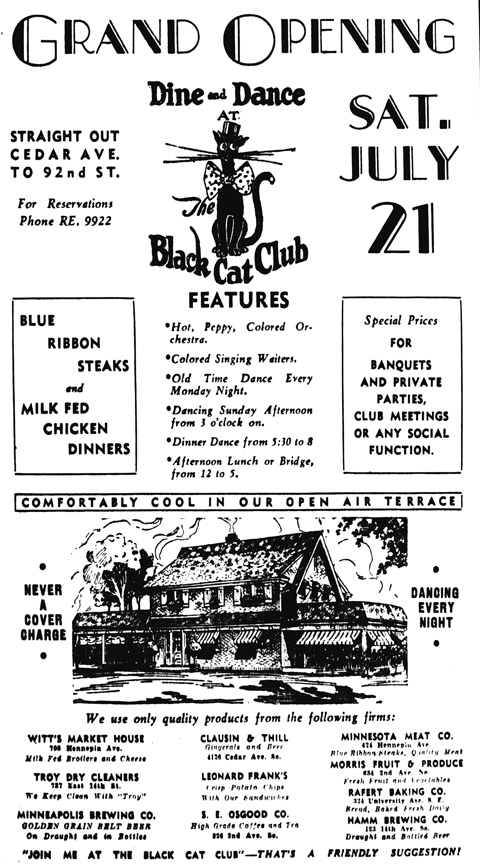
July 21, 1934
Now the ad above is intriguing in a few ways. First, it’s the Grand Opening – perhaps it should be the Grand Re-Opening, since it lost its wonderful name from 1930 to 1933. This is no doubt when the Spencers bought and re-opened the Club. We do know that they owned it by September 16, 1934, from a mention in a column (“Peg About College” in the Minneapolis Tribune). That paragraph calls the “ultra attractive” Chat Noire room “the Twin Cities most beautiful and exclusive suburban restaurant.”
Then there’s the music: “Hot, Peppy, Colored Orchestra,” and “Colored Singing Waiters.” Bill Moore’s many-iterated orchestras were “colored,” that’s for sure.
The last thing is that they provided a sketch of the place, which looks very much like a 1939 photo that Rick Spencer, Al and Rose’s grandson, posted on Facebook. I blew up the 1934 sketch, and I’ll follow it with Rick’s picture.
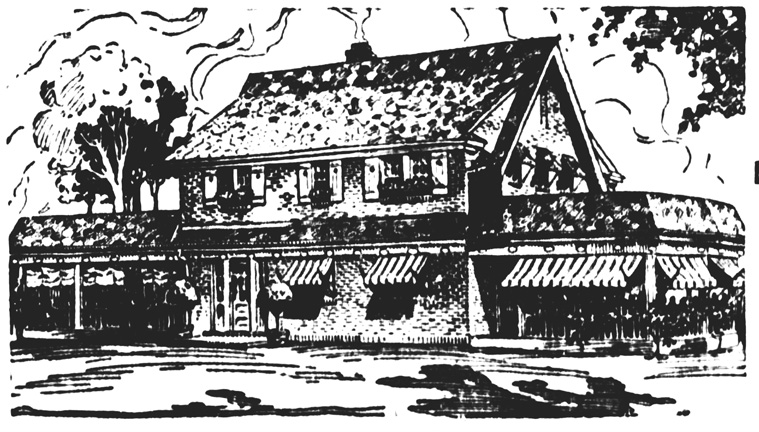
July 21, 1934
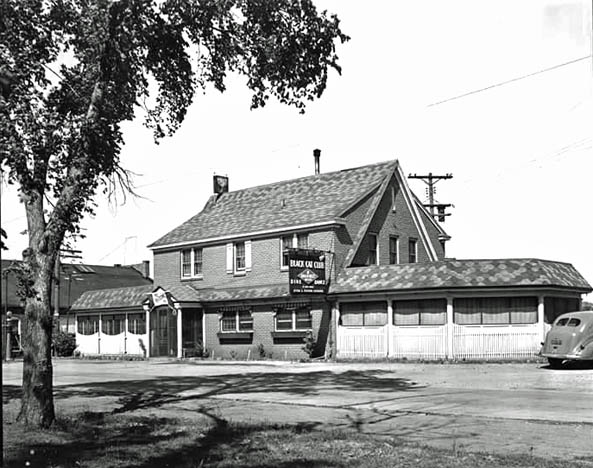
1939 Photo courtesy Rick Spencer
SLEIGH RIDES
A 1936 Valentine’s Day idea floated in the Minneapolis paper was a “Pay Party” – a new New York way of saying Dutch Treat. “Make yours an old time sleigh ride party at The Black Cat Club – $1.00 per person includes sleigh, food and dancing.
These sleigh rides were very popular, especially with fraternities and sororities.
CHANGE OF OWNERSHIP
On April 6, 1941, we find this ad in the Classifieds:
NITE CLUB – Colonial bldg & equipment. All mod liv quarters. Owner has other interest. Take city property in trade. The Black Cat Club, 92nd & Cedar.
An item in the Minneapolis paper dated April 10, 1943, says that Al, formerly with the Black Cat and Cobblecrest Gardens, was now the manager of Jerry Gerow’s President cafe “out across from the ball park. Al’s meeting meat rationing with a trick method of preparing jumbo frog legs. They’re the talk of the section already.”
MELODY INN
Another name change came and went – I can only pin it down to between December 1945 and December 1946. This is the only ad found. The 1946 date comes from a classified about a lost watch.
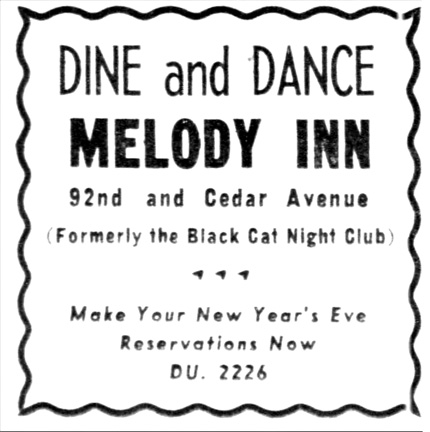
Minneapolis Tribune, December 23, 1945
AND THE CAT COMES BACK
As is often the case, we learn things from crime reports. In this case, we know that the place was back to the Black Cat by January 1, 1951, when two Minneapolis men entered the Black Cat with the stated intent of selling flowers. I instead they accidentally sold a fifth of whisky to an undercover off-duty constable. Trouble ensued.
In May 1954, Otto G. Arnold, President of the Sanitary Sausage Company, was in trouble with the IRS for unpaid taxes. Some of those taxes had to do with unreported dividends from the Black Cat Club, where he claimed “bad debt” that the IRS contended was unsubstantiated. Shortly afterwards, in June 1954, the owner was trying to rent out the club and the kitchen.
One of the last mentions of the Black Cat in the newspaper is a tragic one. On December 11, 1959, 66-year-old Raymond Love of Clarkfield, Minnesota, choked to death on a piece of steak. Love had been at a wrestling match in Minneapolis with his son-in-law, and stopped at the Black Cat for a bite on the way home.
And the last mention found in a search of the Strib is a Lion’s Club meeting held on April 20, 1960.
NICHOLS SUPPER CLUB
A search for the address of the Black Cat brings up the Nichols Supper Club, which first advertised for a cook on December 28, 1961. Those ads continued until January 2, 1962.
THE CAT IS BACK
But wait! Some 1961 State law required bars to apply for liquor licenses, and the Black Cat applied for one in May 1963. Apparently they were successful, because they were advertising for waitresses a week later. Was it all over on March 1, 1964? Methinks the poor old cat, now 35 years old (how old is that in cat years?) was finally gone.
FURNITURAMA
December 1966 to September 1975. Also Bill’s Counters and Floors
ANTIQUE SHOPS
The last use of the building was a series of antique shops. Some of the names were:
- Antique Shop: March 1, 1984
- Antiques in Bloomington: March 1985
- Antiques/Gifts: December 1985
- Sherry’s Old Stuff (aka SOS): June 1989
- Black Cat Antiques: 1979 – 1981, Jan Marie Foster
- SOS: April 1997
This is perhaps our last look at the building. By this time it would have been empty.
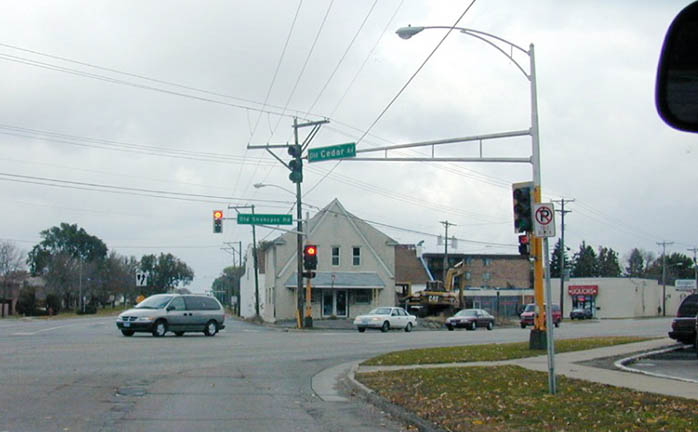
October 2002 Photo taken by Dale Johnson
THE CAT IS GONE
It appears that the building was vacated in about 2000, and demolished in 2002. In its place at the busy intersection is a turn lane from Old Shakopee Road onto Old Cedar Ave. – where the white car is below.
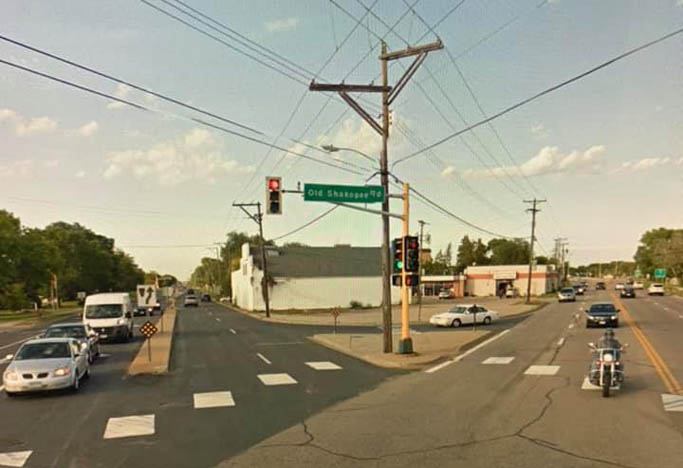
Photo posted on Facebook by Blake Madsden
The Black Sheep Club, 901 Marquette, was supposed to be one of a chain of members-only “Key Clubs” that required patrons to pay a sometimes hefty fee for the privilege of admission. In February 1963 the club held a series of Open Houses, advertising their three rooms:
- The Speakeasy Room had a Roaring ’20s theme with a Dixieland combo and flapper girls
- The Theodora Room was decorated in crystal and velvet and featured Toby Prin at the piano and songs by Lola
- The Oriental Room featured Japanese hostesses singing and dancing traditional songs. In June 1963 belly dancers replaced the demure Japanese girls.
In June 1963 Will Jones wrote about this place as if it had been there awhile. The Four Lads were performing on June 5.
An ad in the July 1963 Select Twin Citian is pretty cute so please bear with me. It’s hand written and all typos are intact here:
Dear Mom & Especially Dad,
Today I sketched a belly dancer … in a fabulous oriental room where everyone sits around on the floor, on pillows. There’s a plush carpet on the stairway that goes from the oriental room to the dining room. Right at the top of the stairs there’s a great chandelier that I understand is worth about $5,000.00, WOW!
In the main dining I met a nice old guy who plays a mean “Ricky-tic” piano. His piano sits in front of a big original painting of a nude (which I didn’t sketch for your benifit!) (mercy!)
The rest of my evening was spent in a nifty room called the “Speak easy” where total choas reigns after nine P.M. Before I forget they’ve got some real top entertainment coming up … Margaret Whiting … Vaughn Monroe and the Cordettes. If you need a membership call Mr. “Bill” Arndt.
I’ve got to run now as I’m going over there for lunch. Great Food at Noon! Love, Bob P.S. send money.

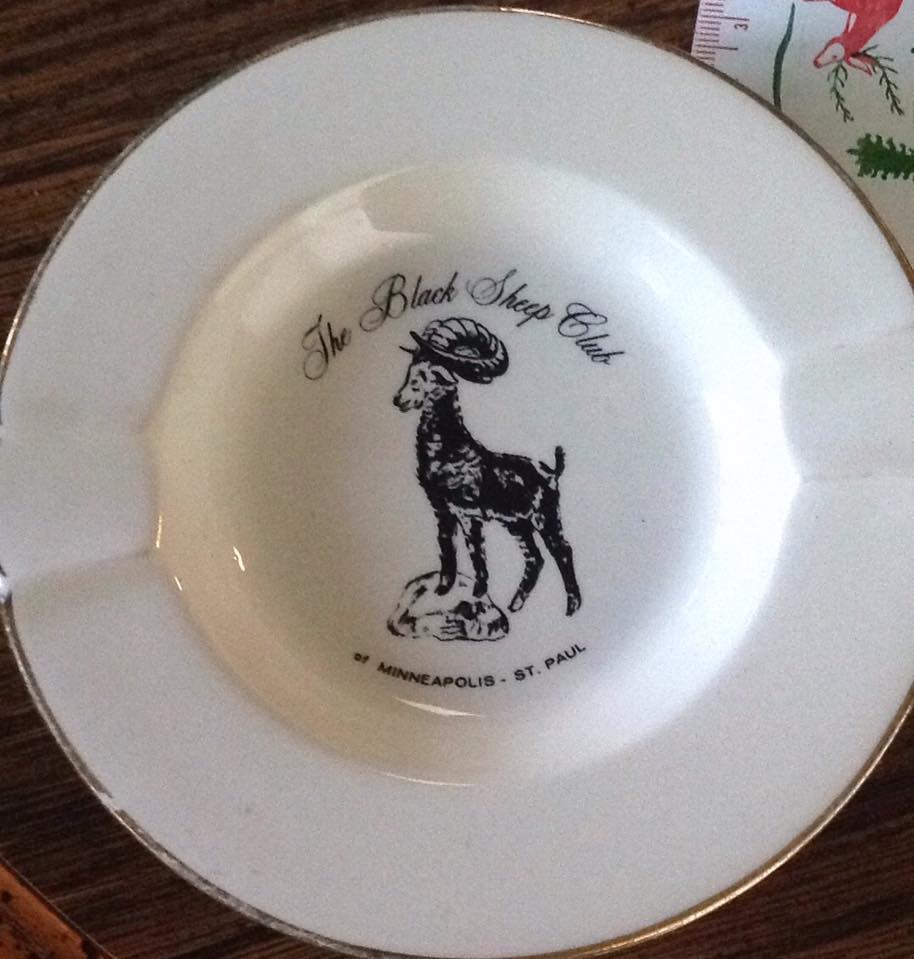
From the fabulous collection of Mark Youngblood!
The project was undercapitalized, and two employees sued for back pay and took the furniture, which ended that.
Subsequent clubs at the location were:
- The Ram’s Club
- Shaw’s Cove – in March 1968, “Introduces a new concept in Night Club Entertaining,” featuring 6-man comedy/musical group called the Second Edition.
- Bradford’s opened in December 1968 by Bernie Beaumont and lasted until at least 1974. The Bradfords was a group from Bradford, England.
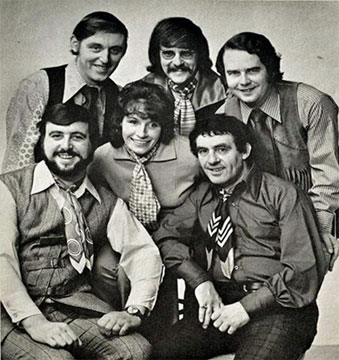
- Zachariah’s was a country place that featured the Sky Blue Water Boys. It opened in October 1975.
The Black Swan Pub was located in the Southdale Bowl, at 3401 W. 69th Street in Edina. The location is now a condo built in 2008.
Entries for the Black Swan appear in October 1971, drop off, then pick up from 1977 to 1990.
A predecessor may have been the Walnut Grill in 1964.
4712 – 42nd Ave. No. in Robbinsdale. Whaddaya think? “Beer, Beverages, and Bait” in 1951. Maybe it had a juke box, who knows?
Please see More Down Stairs.
94th and Lyndale Avenue So.
This page is about two venues that were located at 369 Cedar Ave. in St. Paul:
- The Take 5 Jazz club
- The Blue Chip
TAKE 5 JAZZ
An ad for Take 5 Jazz appears in July 1972.
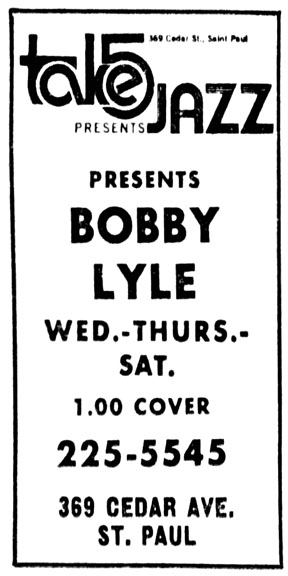
Minneapolis Tribune, July 12, 1972
It’s difficult to know how long it lasted, because the name of the place is in an unsearchable font.
THE BLUE CHIP
Ron Mattox took over the Take 5 and turned it into the Blue Chip.
Will Jones tells us that the Blue Chip had a Wall Street theme:
Fashioned out of the not-so-old Take Five jazz club, it’s nestled in the parking complex in the shadow of the Osborne Building at 369 Cedar Ave. So. About all owner Ron Maddox did to remodel the place was change some lighting and install a huge electronic board that flashes the New York Stock Exchange quotations, as in a brokerage house. After the market closes, the board continues to flash the closing numbers and continues as a kind of light show through the evening. Cocktail doilies are $100 bills featuring a picture of Maddox, and Wall Street Journal reprints cover the menus and uniforms of bartenders and waitresses. (Minneapolis Tribune, August 20, 1973)
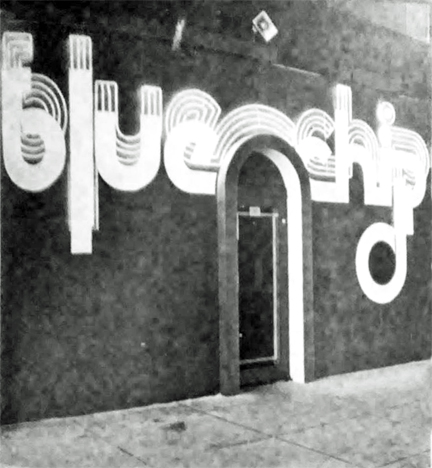
Image from Twin Cities Unabridged Book of Where its at in Minneapolis, St. Paul and Suburbs, 1976, courtesy Lisa Knops
John Gehrke of the Minneapolis Tribune wrote:
While businessmen aren’t overwhelming the Blue Chip, many go there for entertainment. You’ll also see an occasional judge or legislator, and the city council convened there one recent afternoon for undisclosed purposes. (December 3, 1973)
Facebook and Other Facts:
- The Blue Chip had “Large Lung” contests in about 1973.
- Maddox also installed a Dow Jones News Service teletype machine.
- The waitresses and bartenders wore shirts printed with reproductions of pages from the Wall Street Journal.
- In August 1975, an ad appeared, selling chairs from the Blue Chip.
- Norm Stratton was the lead singer of the house band Second Coming. The band hit it big and moved on to Vegas.
- Members of the Minnesota Fighting Saints hockey team hung out there.
On April 26, 1978, owner Ron Maddox was elected to the St. Paul City Council. A brou-ha-ha erupted in July 1978 when people objected to a bar owner voting on liquor license matters. At the time, Maddox said he was in the process of selling the Blue Chip. Indeed, wantads looking for a buyer begin to appear on December 2, 1976. An article in the Tribune dated July 14, 1978, described Maddox as a former St. Paul bar owner, so he must have sold the Blue Chip very shortly before that date.
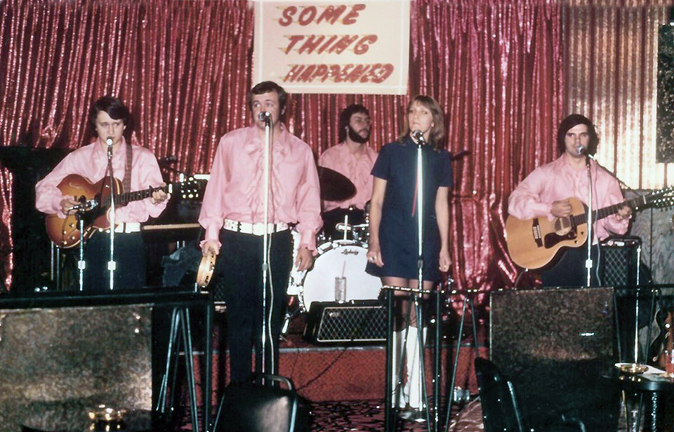
The Some Thing Happened band at the Blue Chip. Photo courtesy Kari Fox
RON MADDOX
Ron Maddox was a huge booster of his adopted City of St. Paul. He apparently owned a hardware store (Ron Maddox Highland Repair) and operated an insurance business, but his real profession was bar owner, having stakes in seven of them throughout his lifetime, according to his obituary. Some highlights are below (more to come):
March 1, 1970 – January 1972: Denny’s Loft
Blue Chip: August 1973 to July 1978
Before December 1973: Plucked Raven
Before December 1973 to February 1976: Green Lantern – on 369 Cedar with the Blue Chip
October 20, 1974 – April 1976: Fringe Benefit Bar, located at 312 Central Ave. NE in Minneapolis (partial ownership)
In 1982, Maddox heard about the music festival idea while in Chicago, and organized the Taste of Minnesota for first time.
Maddox died from complications of strokes on February 19, 2010.
1105 – 26th Ave. No. Not sure if this had any entertainment, but here’s a story in case it did. In March 1968 a bomb was thrown into the entryway, blowing an 11-inch hole in the concrete of the building’s basement, blowing the door off its hinges, and breaking its front windows. Eight idiots were arrested and charged, including three women; they told police that they planned to form a local chapter of Hell’s Angels. The bombing followed an earlier brawl at the bar, and co-owner Erling G. Nelson and two young men injured in the fight reported they had received threatening phone calls.
Not the infamous gang hangout in Garrison, Minnesota, this Blue Goose Inn was located at 2754 W. 7th Street in St. Paul, according to an item dated April 10, 1929, advertising for a piano player.
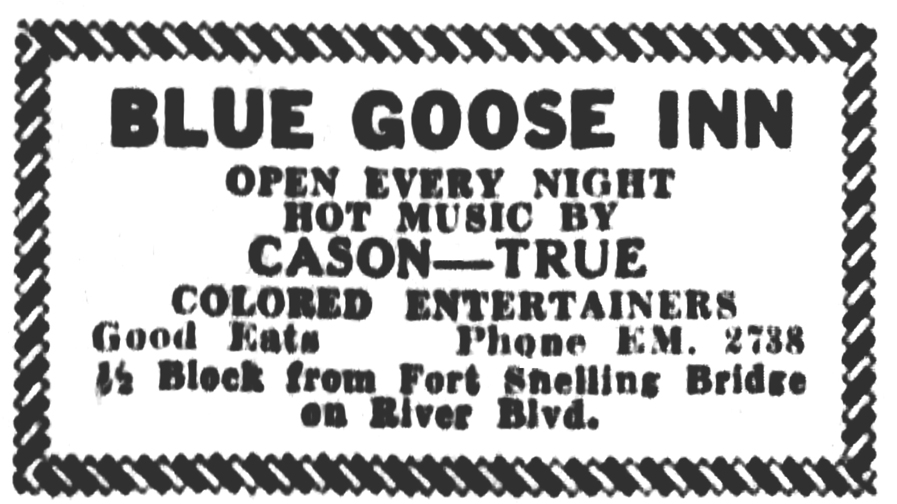
Minneapolis Tribune, October 24, 1930
THE GOLDEN TAVERN
In February 1933, the Blue Goose Inn became the Golden Tavern.
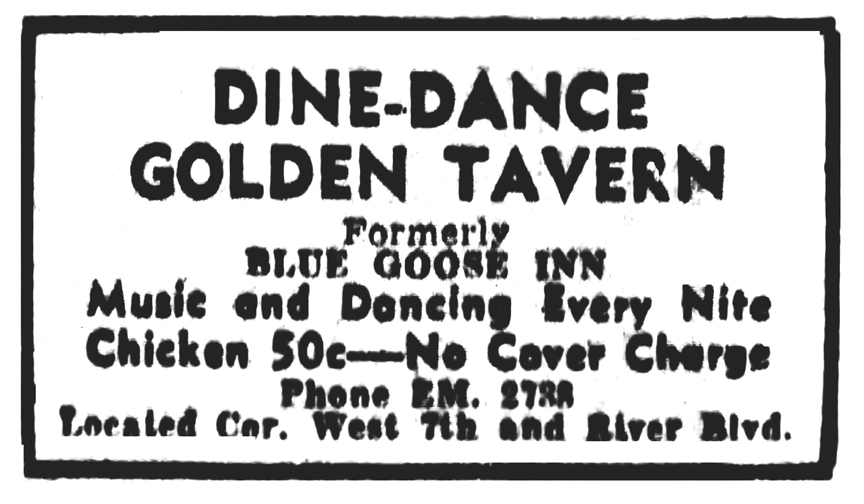
Minneapolis Tribune, February 17, 1933
The last mention of the Golden Tavern in the Minneapolis papers was on October 17, 1935.
6810 Lake Drive, Circle Pines, 1974.
1355 University Ave. W. in St. Paul was the site of several music venues over the years. Many thanks to Jeff Neuberger for his research on this location!
THE PEACOCK INN
Opened in October 1926, the Peacock Inn offered elegant dining and dancing to live music by Don Yerkey and his orchestra. It also offered alcohol, and on December 25, 1928, the Peacock Inn was raided by Prohibition agents and a Federal judge ordered the restaurant padlocked.
DEAUVILLE CHATEAU
After remodeling, the Peacock Inn reopened in 1929 as the Deauville Chateau. It was decorated to resemble the famous French seaside resort. Napoleon de Roma was the owner. He had formerly managed the Casino Room at the Saint Paul Hotel. The Deauville Chateau offered French cuisine and live music to dance to. Bill Santos and his Tropical Melody Orchestra played tango music. They also had Marshall Stanchfield and his Orchestra with Rita Gould as vocalist. A Filet Mignon steak dinner could be had for 75 cents and mixed drinks for a quarter.
NAPOLEON’S
By 1937 Napoleon de Roma had changed the name of the restaurant to Napoleon’s and continued to offer fine cuisine to the citizens of St. Paul. De Roma ran the restaurant until his death in 1949 and then his son Herbert Napoleon de Roma took over.
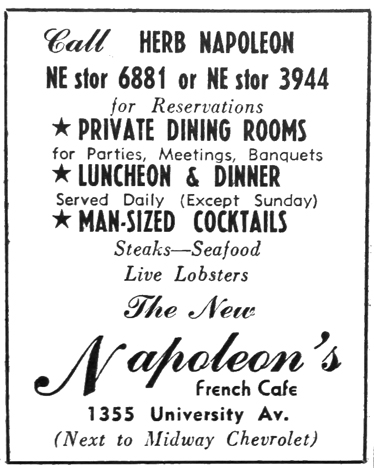
1954 St. Paul Phone Directory Ad
Napoleon’s continued to be a St. Paul institution for power brokers, society parties and business lunches.
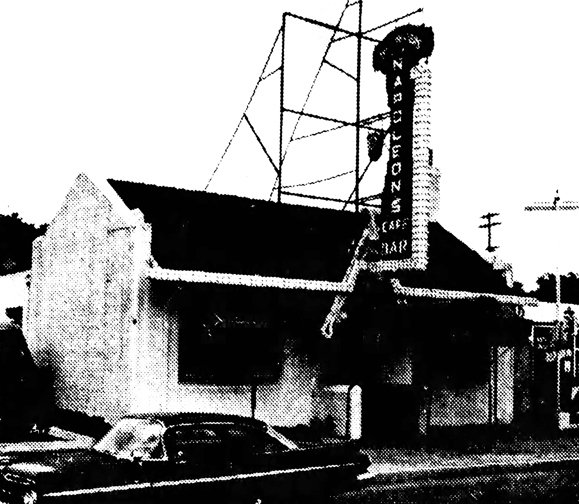
Napoleon’s, Minneapolis Star, June 1, 1963
BLUE HORSE
In 1963 De Roma sold Napoleon’s to Ralph Kriesel, who owned the nearby Midway Chevrolet. Kriesel leased the restaurant to Vernon Warling, who after a few months remodeling reopened it as the Blue Horse restaurant. Vernon brought in his brother Cliff to run the place, and Cliff was referred to in press reports as the owner.
The Blue Horse was primarily a restaurant, often patronized by politicians and known for lavish dishes such as:
- Steak tartare
- Steak Diane
- Bananas Foster
- Cherries Jubilee
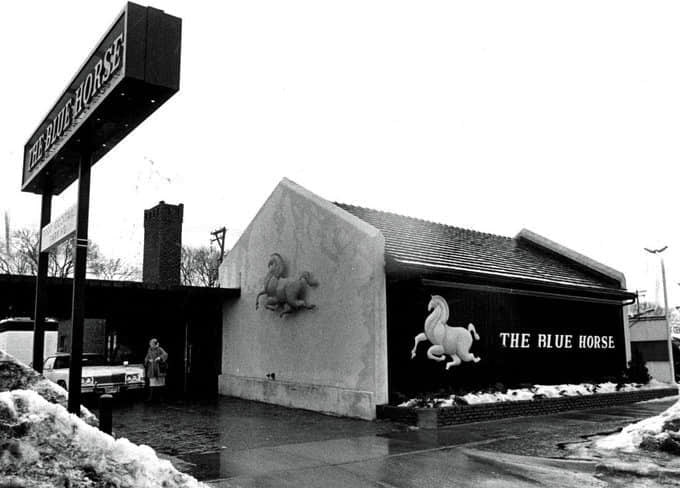
The Blue Horse – photo courtesy Steve Berc
Family member Tom Warling tells us that the iconic Blue Horse sculpture was taken from a painting by Franz Marc. Club owner Leo Gadbois reportedly had or has one of them at one of his properties.
Although it was not necessarily a music venue, it did have a piano bar.
It was closed by Cliff’s son John Warling in October 1991.
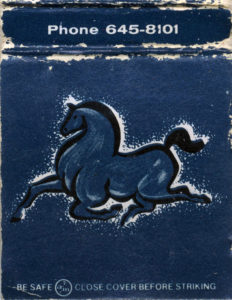
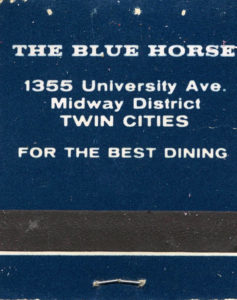
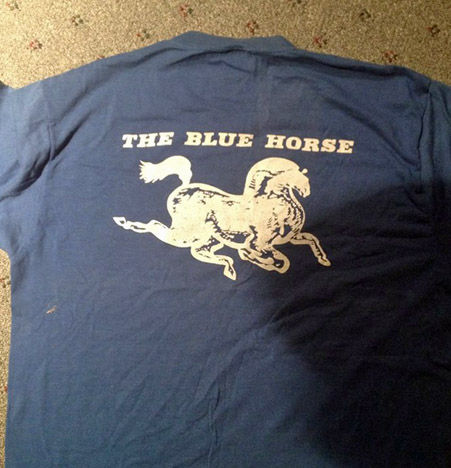
Blue Horse Tee courtesy Mike Carnis
Save
The Blue Lantern was a night spot on Sixth Ave. No. in the 1920s.
The Blue Moon Cafe and Club was on the north side of Sixth Ave. No. between Bryant and Sumner Place.
Please see Lyceum Theater
The Blue Note Cocktail Lounge was located at 622 – 11th Ave. No. in Minneapolis.
Formerly Leo Roth’s Bar, it opened on October 9, 1962. Boyd Yancy and Thomas A. Lewis were the proprietors and Tilly Anthony was the manager. Jazz venue, favorite of Dave Moore.
Tommy Lewis was shot and killed on August 24, 1969.
From 1967 to at least 1972 the owners were Benjamin W. Fields and Claude S. Thomas. In a 1972 interview they said that business was down because more blacks were going to downtown clubs. Thomas said that when he first got there in 1967 “I thought I was in a western movie” for all the people with guns in the place. Still there in 1974.
The Blue Ox was located at 918 Third Ave. So. in Minneapolis.
It opened in March 1963 with “no strippers and no twisters,” reported Will Jones of the Tribune. A co-owner was Ockie Berman. Another owner was David P. Aronsohn. It was open by March 15, 1963.
Ads promised “Floor Shows! Dancing!” Kitty and Her Aly Kats were the featured performers in 1963-64.
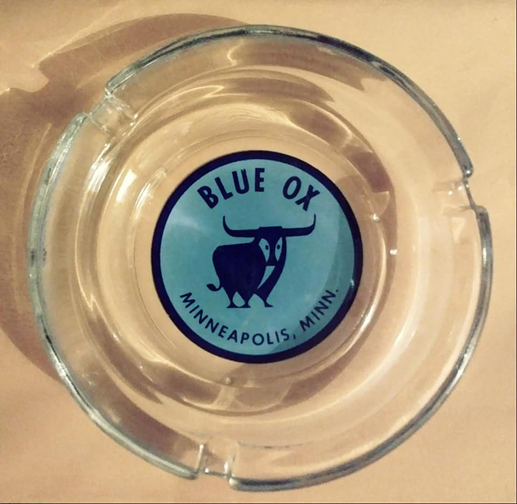
Blue Ox Ashtray Image Courtesy Roger Sessions
1969: Dining, dancing and floor shows such as the Jolly Jacks and Fraser & Nevers in the main lounge.
In the Blue Room (where the swingers are), sing along to Judy Moen and Valerie.
Facebook Facts:
- “They had a few booths back in the corner that had telephones in them. I knew a couple bookies that took their action there!”
- In the 50’s, it was owned by Bill Craig.
- Chef Earl Miller
- Kenny & Moose Tending Bar !!!!
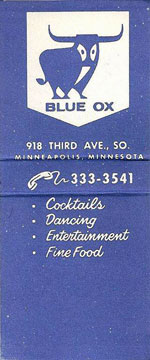
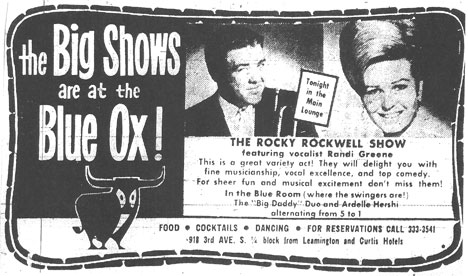
1967
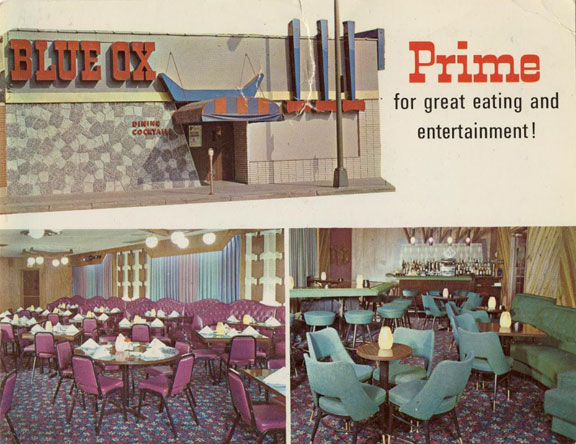
- Mid-December 1984: Last ad?
- March 1985: New Rock club, John Sean Clerken new owner
- September 1986: Clerken aka Sean’s Irish Pub filed Chapter 11
- February 21, 1987: Auction
Save
U of M, early 1940s.
The Booker T Cafe, sometimes seen as the Booker T Tavern, was located at 381 Rondo Ave. at Western Ave. in St. Paul. There was also a second location in Downtown St. Paul. This is a difficult tale to tell, because there are actually four venues involved, several addresses, and the history is totally non-linear. I will do the best I can. I am deeply grateful to members of the Ellis family for their contributions to this page.
IMPORTANT NOTE
My sources for this page were the Minneapolis Star and Tribune, accessed online. The St. Paul Dispatch and Pioneer Press are not available online, and although they are available at the Minnesota Historical Society on microfilm, they are not searchable. I have also done a search through the St. Paul Recorder, a weekly newspaper for the black community.
Jeremiah Ellis, a descendant of Mance Ellis, has requested, and rightly so, that I include this paragraph that acknowledges the inherent racism of the mainstream press of the day:
This article is deeply limited by the inherent bias in the mid-century media reporting upon which it is based. The narrow reporting and narrative does not depict the fullness of African American individuals nor account for their broader impact in the African American community. Complicit in this biased worldview are the policy makers who, in their administration and regulation, prioritized land and property over Black livelihood and people.
381 RONDO
There are few resources available about St. Paul buildings. The Minneapolis papers reveal that:
- Bessie Pierce ran a tavern at 381 Rondo Street in July 1936.
- In February 1944, John C. McGee, Cafe owner, plead not guilty to the charge of selling liquor to an Indian woman.
- The building was a tavern in January 1945.
- It is unclear when the building at 381 Rondo Street became Booker T – a guess is between 1947 and 1950.
THE ELLIS FAMILY
The Booker T was owned by Mance Ellis, who was born in 1896 in Mexia, Texas.
Jeremiah Ellis:
When viewed through the national lens of the Great Migration, Mance Ellis was a migrant who sought greater opportunity for his family outside Jim Crow oppression of Texas. He journeyed with his wife, young children, his sister and his little brother the 1,100 miles from Texas, to Minnesota, seeking space to carve out a life for himself and his family and believing Minnesota would allow upward mobility. However pre-civil rights era Minnesota unraveled those aspirations. In 1945, 321 of the 601 Twin Cities employers who responded to a survey said they would not be willing to employ African Americans.
We do know that in 1940, and up to at least 1947, Mance Ellis owned his own business as a decorator on Rice Street and County Road D in St. Paul.
Kamuel Ellis Family:
Mance and his wife Mattie Ellis had four sons (Herman, Rudolph, Booker, and Kamuel) and two daughters (Ella Mae and Rosemary) who survived to adulthood. The property on Rice Street and County Road D in St. Paul was referred to as The Farm. Mattie Ellis was a Deaconess at St. James AME Church in St. Paul.
THE BOOKER T
Mance named the Booker T after his son, paying homage to Booker T. Ellis’ illustrious boxing career (26 wins [11 KOs], 21 losses [4 KOs], 4 ties) in the 1940s. Because of his boxing days, Booker T was a celebrity in the Rondo neighborhood. Also involved was Mance’s son Rudolph K. (Rudy) Ellis, who was born in 1924 in Minnesota.
Jeremiah Ellis:
From a Minnesota economic perspective, the Booker T was intended as a protective shield to counter oppression directed toward Minnesota Black men. For Mance’s sons Booker T. and Rudy, this protective shield was both an inheritance and a commitment to Minnesota.
The Kamuel Ellis Family:
The Booker T on Rondo, the second location in Downtown St. Paul, and other manifestations are part of the community and Ellis Family lore. The Booker T was a Barbeque Rib restaurant and grocery store for the Rondo community in St. Paul. Its history as a music venue is anecdotal and based on family stories of Jazz, including friendships with Dizzy Gillespie and Ella Fitzgerald. Music was part of this tavern, Barbeque Rib joint, bottle club, etc. – a speakeasy with food, et al after hours that spans from the late 1950s to the early 1960s in the Rondo community.
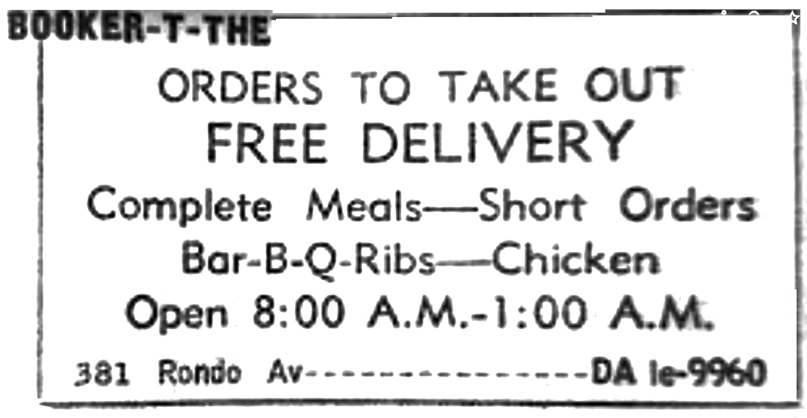
Phone book ad courtesy Jeremiah Ellis
THE BOOKER T AFTER HOURS
As noted above, after the grocery store and restaurant closed for the night, the Booker T became an after-hours club where drinks (or set-ups) were served, music was played, and people danced. It was located on Rondo Ave. in St. Paul, the hub of black commercial and social life in a segregated city where there were few choices for entertainment, no matter what your financial or social strata. Name entertainers would drop by after their shows Downtown and relax with the locals.
In January 1960, Mance reported that someone broke into his place at 381 Rondo and stole cigarettes, money, tubes and recording chassis from the juke box, a case of beer, and 25 barbequed ribs. The robber probably enjoyed the ribs the most; Mance Ellis was famous for his barbeque sauce and took the recipe to his grave.
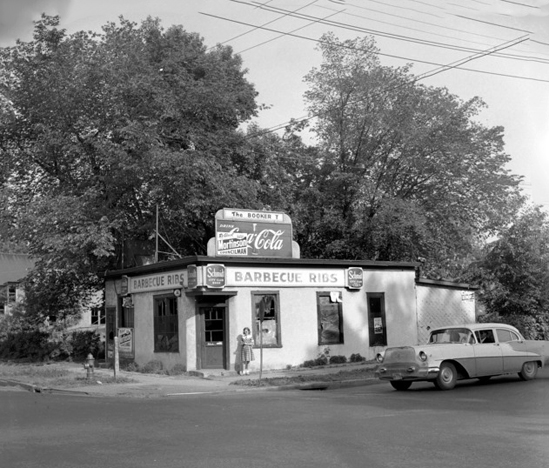
June 9, 1960 photo courtesy Minnesota Historical Society
The building, along with most of the Rondo neighborhood of St. Paul, was demolished for the construction of Interstate 94. The section between Minneapolis and St. Paul was completed in 1968.
BOOKER T CAFE NO. 2
A second Booker T Cafe shows up on or before July 1959, which either moved around a lot, or had a peripatetic address. In July 1959 it was described in the Recorder as 447 1/2 Broadway in a story about someone who took coins from a jukebox and 25 pounds of ribs. Turns out it was an inside job. The perpetrator admitted to taking the ribs but not the coins.
In September 1959, the Recorder gave the same cafe’s address as 579 1/2 Broadway. This comes from a report of a sting and arrest of a waiter for selling liquor without a license to a “Pretty N.Y. Policewoman.” The waiter got a sentence of $100 or 10 days. Mance Ellis, proprietor of the Booker T, was notified to report to the Morals Division Office.
St. Paul bootleggers are reportedly nervous and worried over the new departure of the St. Paul police in securing evidence. One “legger” said “the town’s getting hot, guess I’ll have to get me a job.” (St. Paul Recorder, September 25, 1959)
The next time we see the Booker T No. 2 is in November 1959, when Mance and an employee were having a go about wages she said she was due. The police were called, she had a go at them too, and off to jail she went. She was given a 15-day suspended sentence. The address of the Cafe was given as Grove and Broadway.
All of these addresses are gone, but as far as I can tell were in the same general location, in the northeast section of where Highways 94 and 35E come together.
THE RONDO IMPROVEMENT ASSOCIATION
Mance Ellis was also the proprietor of the Rondo Improvement Association, 588 Rondo Ave. His partner was German Sperling, who owned the building. From about 1957 to 1959, the St. Paul Recorder published these ads weekly:
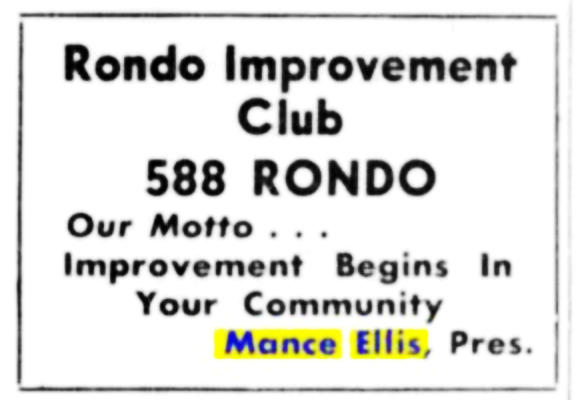
St. Paul Recorder, February 2, 1957
BOTTLE CLUBS
Although this organization appears to have been styled like a service club like the Rotary and the Kiwanis, it did fit the description of a “Bottle Club,” where members would bring alcohol and drink and (I hope) dance until the wee hours. Since they were not regulated, they stayed open whenever they wanted.
Bottle clubs became popular in the Rondo community because segregation made black people unwelcome in white clubs, and there were few opportunities for black entrepreneurs to start their own clubs. The clubs on Sixth Ave. North in Minneapolis had been removed and there were fewer and fewer places to go.
NORTH CENTRAL COMMUNITY ASSOCIATION LETTER
But the Rondo Improvement Club’s activities were not going unnoticed. These are excerpts from a letter sent on January 21, 1958, to the St. Paul Commissioner of Public Safety by an organization called the North Central Community Association:
We are writing you of our grave concern, relative to the appalling increase of disreputable clubs, and “after hour joints” operating illegally,, in the Rondo-St. Anthony area. The coming of the proposed Freeway through her and the scarcity of suitable sites has caused many of these clubs to seek to establish themselves in private homes and others to relocate deep into the residential area. The apparent big profit and freedom of operation seems to be the cause for the continued existence of most and an incentive for others to form. These clubs obviously are a public menace and a hot bed for crime and vice in the neighborhood.
We cannot over emphasize the fact that a petition is already on file against the club operating at 588 Rondo Ave. This club advertises in the paper for memberships and operates full-force illegally after legal establishments close. It is gaining a wide reputation as a good time wide open club which attracts many undesirables in the Twin Cities and the upper midwest. Vile and vulgar language is frequently used in the presence of passing school children.
Published in the St. Paul Recorder, January 31, 1958
THE TURTLE CLUB
The Turtle Club appears to have been the same kind of organization as the Rondo Improvement Club – references in the St. Paul Recorder show that it provided scholarships and prizes for different events in the community. The treasurer was Rudy Ellis, Mance Ellis’s son. Booker T. Ellis was the acting secretary of the Turtle Club at one point. The Club started with a membership of 400, and by 1958 it had grown to 1,000. The Turtle Club was also mentioned in the letter to the police of January 21, 1958, quoted above.
THE BOTTLE CLUB RAID
At 2:19 am on January 25, 1958, 211 people were arrested in raids of the Rondo Improvement Association and the Turtle Club – described as the biggest raids in St. Paul history. The City’s Chief of Police personally led the raids, along with 70 police officers. One description of the raid said that the customers just kept on dancing until they were rounded up – music!
Both Mance and Booker T. Ellis (and their partners) were released on $200 bail. They were also charged with disorderly conduct. (Minneapolis Star, January 25, 1958)
THE TURTLE CLUB REDUX
The January 1958 raid of the Rondo Improvement Association may have meant the end of that particular institution. Reading through the St. Paul Recorder, it seems clear that Mance Ellis was a prominent member of society and his church, and may not have wanted to associate himself with anything unsavory.
But the Turtle Club lived on, and would do, in theory, for six more years.
Searching for the Turtle Club found it at several addresses. The first address noted in January 1958 was Western and Rondo. An item from April 1959 about a shooting cited 395 Rondo. Another report said 354 Rondo.
On September 18, 1959, the State Highway Department took possession of the Turtle Club and finally closed it for good. BUT… the article didn’t give the address of this particular Turtle Club, which was described as a two-story frame structure.
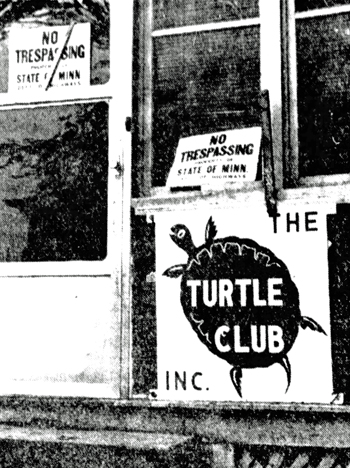
Minneapolis Star, September 19, 1959
582 RONDO
The Turtle Club wasn’t licked yet, and by 1960, it had moved on to 582 Rondo, where it stayed until the bitter end.
In June 1960, an ordinance regulating Bottle Clubs was being discussed in St. Paul. Mance’s son Rudy was identified as the operator of the Turtle Club. The ordinance passed. The Turtle Club was described as the best known of the bottle clubs, having a capacity of 200, with many of its patrons coming from Minneapolis.
The club’s application to renew its bottle license was rejected on June 30, 1963. The Turtle Club was no more. At least legally.
ONE SINK VS UNITED STATES
On October 9, 1963, an IRS Agent and St. Paul Police raided the Turtle Club, described as a “former bottle club,” confiscating liquor, fixtures, and gambling equipment. It’s unclear whether there were any actual customers in the place – no arrests were made, and the Turtle Club was never charged with a crime.
But as a result of the raid, St. Paul attorneys Douglas Thomson and John A. Cochrane filed a lawsuit entitled “One Sink et al. versus the United States of America.” The suit charged that the sink’s Constitutional rights were violated when it was “rudely torn from its natural appurtenance” behind the bar in the basement of the Turtle Club. The suit asked that the sink – and all items taken in the raid – be suppressed as evidence and returned to their natural state.
Assistant Federal Attorney Sidney P. Abramson, defending the USA in the case, asked the judge to throw out the case, claiming that One Sink had no legal claim – “without a stopper.” Thomson countered, “This case has been a terrible drain on our firm, but we feel we come into court with clean hands.” (Minneapolis Tribune, January 26, 1964)
Well, the hearing began before U.S. District Judge Earl R. Larson. The suit was in Federal court because of the presence of the IRS agent. On July 16, 1964, Larson “politely” threw the suit out, ruling that the sink did not have any rights under the 4th Amendment of the Constitution. Larson also held that the U.S. District Court did not have jurisdiction, because the IRS Agent had only observed the raid, which was planned and carried out by St. Paul Police. Cochrane opined that “We hope all our efforts have not gone down the drain.” (Minneapolis Star, July 18, 1964)
Not to be dissuaded, Cochrane brought the suit to the the Circuit Court of Appeals in St. Louis, but it was thrown out of that court as well, on July 17, 1964. Cochrane had failed to pay the $25 filing fee. (Minneapolis Star, July 18, 1964)
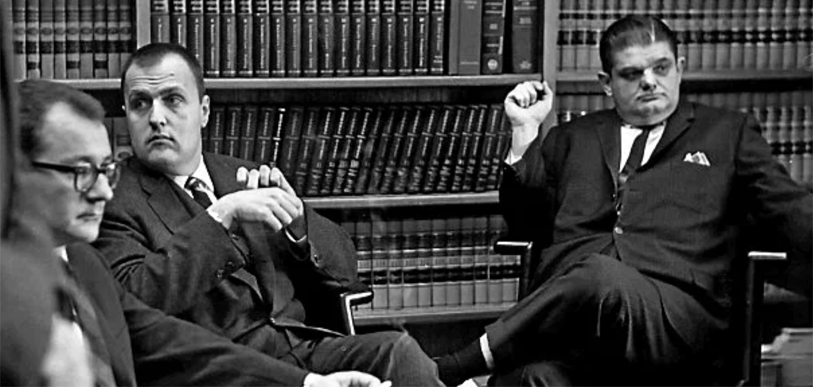
Douglas Thomson, John S. Connolly, John A. Cochrane, May 1, 1963. Photo by Don Church, St. Paul Pioneer Press
CODA
Booker T. Ellis died March 15, 1965, at age 43 and is interred at Fort Snelling
Rudolph Ellis died in November 1965, at age 42 and is buried at Oakland Cemetery in St. Paul.
Mance Ellis outlived both Booker and Rudy. He died in February 1972, at the age of 76 and is buried in Oakland Cemetery near wife Mattie and son Rudy.
Kamuel Ellis died in September 2013, at age 86 and is buried in Oakland Cemetery.
Jeremiah Ellis:
When viewed through a modern trauma-informed perspective, the consequences of forced closures of The Booker T and other Rondo community assets looms heavy on the misfortunes of Booker T. and Rudy Ellis in the years that followed. With their inheritance stolen, their early deaths in 1965 were hastened, Booker T. at 43 followed by Rudy Ellis at 42. The Ellis family is but one example of why the Minnesota Department of Transportation formally apologized for the decisions to demolish Rondo Ave., resulting in Interstate 94 in St. Paul today.
Bootlegger Sam’s was above Mama D’s Italian Restaurant in Dinkytown.
The Bottle Inn was located at 225 W. 78th Street at Pleasant Ave. So. in Bloomington. Here’s a long shot of the street, with the Bottle Inn right in the middle.
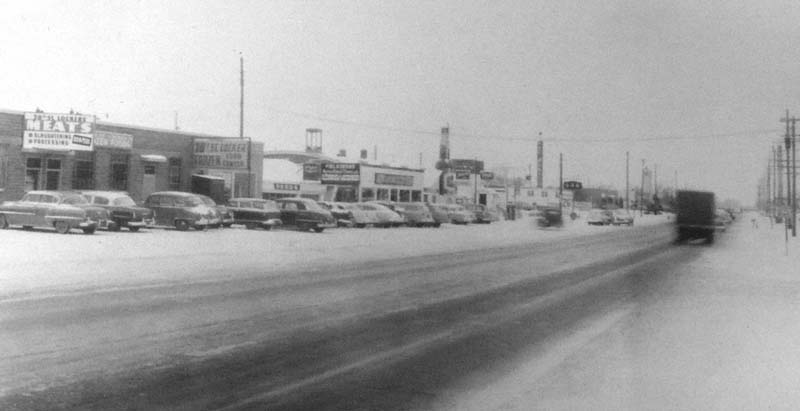
Photo courtesy Bloomington Historical Society
According to the folks on Facebook, the building was in the shape of a huge bottle, and was a tourist attraction. An ad says it was “Known from Coast to Coast.” Jean Bellefeuille of the Bloomington Historical Society, who was kind enough to send the photo below, said that Pete Bove, a sign painter for Naegle, painted the large bottle sign that was the front facade of the building. The photo may have come from Stan Danielson. Here’s a closeup:
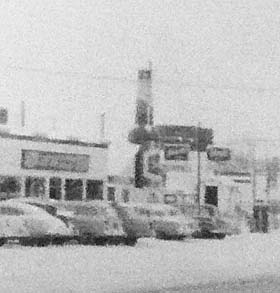
Photo courtesy Bloomington Historical Society
In April to September 1937, it was operated by Ernie Fisher.
On May 28, 1938, six men were arrested in an “affray” to do with picketing of the Inn. (Minneapolis Star, June 9, 1938)
An ad in the Republican Register dated October 1940, tells us that the Bottle Inn’s proprietor was Carl Miller, and that it had “Dancing Every Nite.” The address was given as just 78th Street.
Music was provided by the Bottle Inn Orchestra, which made the records shown below. The images come from Gary Anderson, whose father was in the Orchestra.
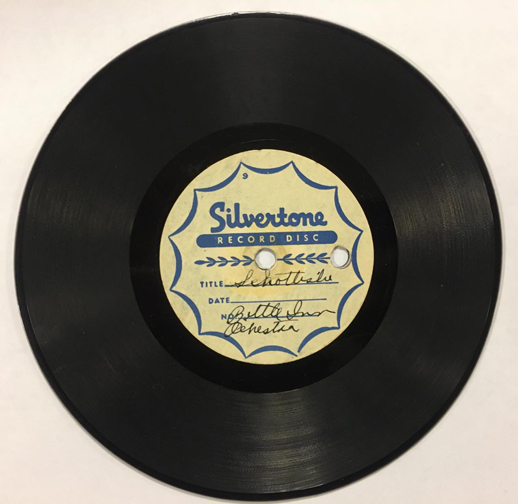
Image courtesy Gary Anderson via Terry Ahlstrom
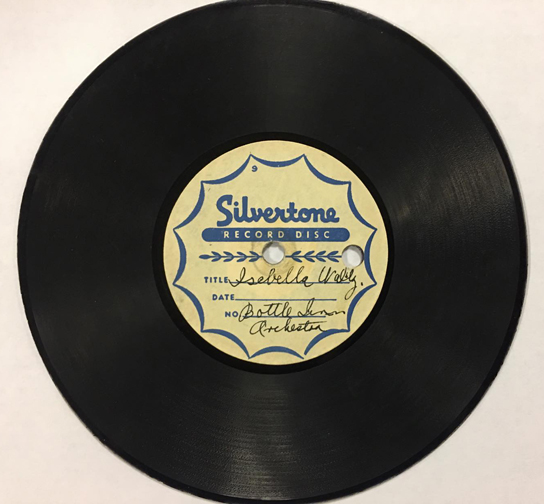
Image courtesy Gary Anderson via Terry Ahlstrom
TRAGEDY AT THE BOTTLE INN
In June 1942, a grisly truck/motorcycle accident occurred outside the Bottle Inn, when a young man took a 14-year-old girl he met there dancing on a ride on his motorcycle. They were hit from behind by a truck hauling ten tons of cattle. The truck driver was not speeding and swore he did not see the light on the motorcycle, which may have been covered by the girl’s coat. He was not charged. The young man was killed and the girl was severely injured. Fortunately, a doctor was in the car behind the truck and applied a tourniquet to the girl, although she ultimately lost a leg above the knee. (Minneapolis Star, June 24, 1942) In August 1942, a benefit was held for her at the Bottle Inn.
ENTERTAINMENT AT THE BOTTLE
Oh, here’s a sad one. Says here in a 1948 article that proprietor Paul Hammer installed the latest model General Electric television at the Inn and summarily fired the barbershop quartet that had been providing the entertainment. Hammer considered it an opportunity to provide entertainment without extra charge.
He planned to have daily broadcasts at 4:00 and 7:50 pm each weekday, working up to 30 hours of TV entertainment every week. KSTP was the first and only TV station in 1948, and the news was on at 7:50. Usually there was a baseball game or football game that started at 2:00, so the 4:00 time is a bit of a mystery. Maybe the Bottle Inn was the Twin Cities’ first sports bar! Thanks, Terry Ahlstrom!
In June 1952, Paul Hammer owned a slot machine license at the Bottle Inn. Hammer was also one of a shrinking number of people holding a slot machine license in January 1954.
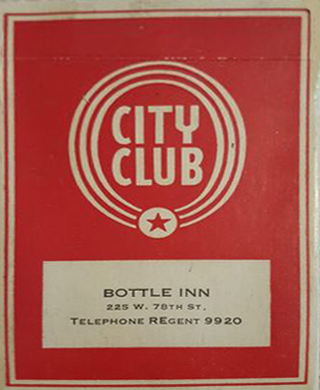
Bottle Inn Playing Cards! Photo courtesy John Yetzer
BOTTOM OF THE BOTTLE
The contents of the Bottle Inn were advertised for sale in November 1957. The site was probably destroyed by the construction of the I-494 interchange at Nicollet Ave., and is now the approximate site of Sam’s Club on American Blvd.
There were at least a couple of establishments called the Boulevard; this one was at 5530 Wayzata Blvd. in Golden Valley. Until 1931, the road would have been referred to as Superior Boulevard.
This Boulevard Cafe started out as a run-down roadhouse, owned by William J. Schindler, who had owned Bill’s Place (5410 Wayzata Blvd.).
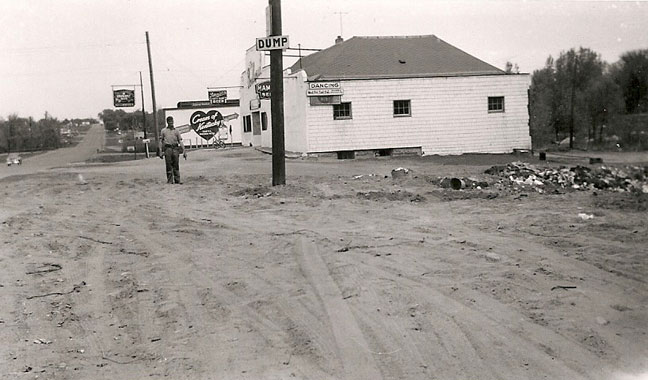
Boulevard Dance Hall
Harold and Cecelia Lynch became partners in the place in 1943.
In 1945 there was Dancing Every Night – it was probably an early jazz venue.
Iver Stanger was the proprietor in 1945, and he put his name on every ad. And the ads were very verbose. He called the place the New Boulevard.
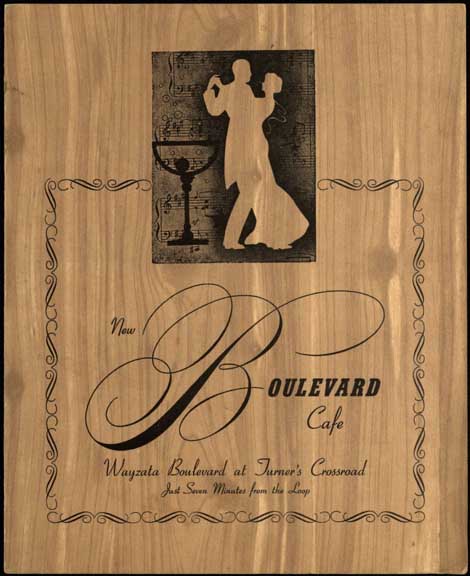
This looks like an early menu. Image courtesy Hennepin County Library
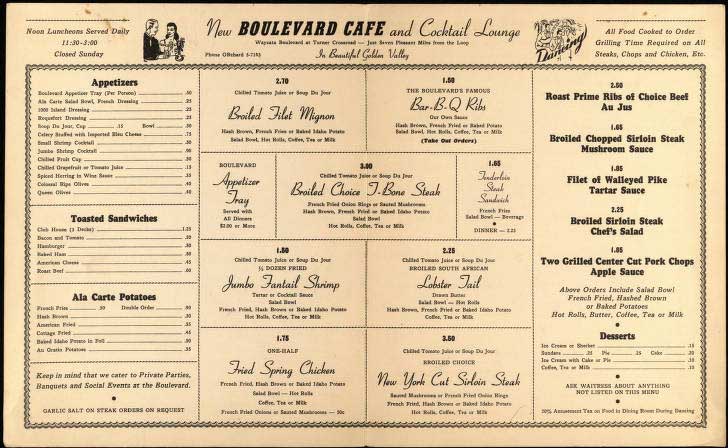
Image Hennepin County Library
In August 1945 Stanger lost his on-sale liquor license because too many had been issued.
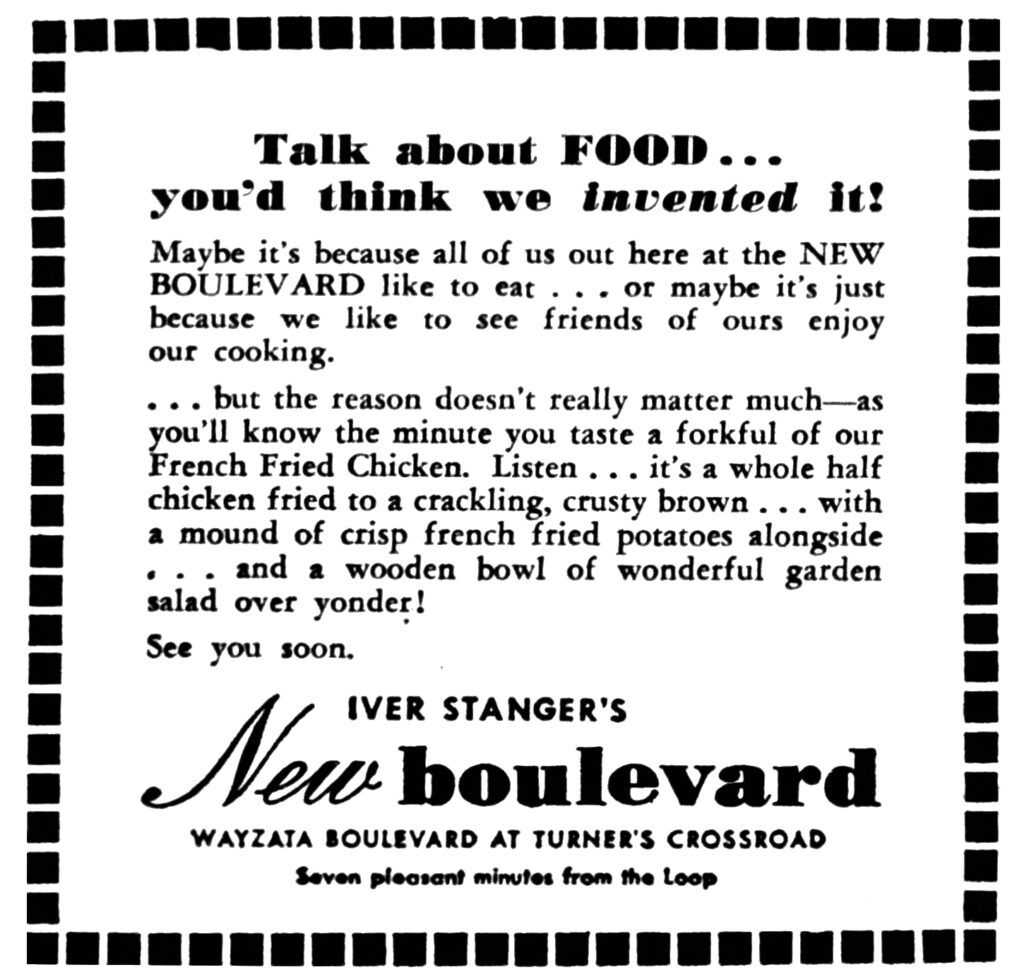
Minneapolis Star, October 16, 1945
The place was raided on August 30, 1947, for illegal liquor sales.
Here’s a view from the inside, taken on Mother’s Day, 1948.
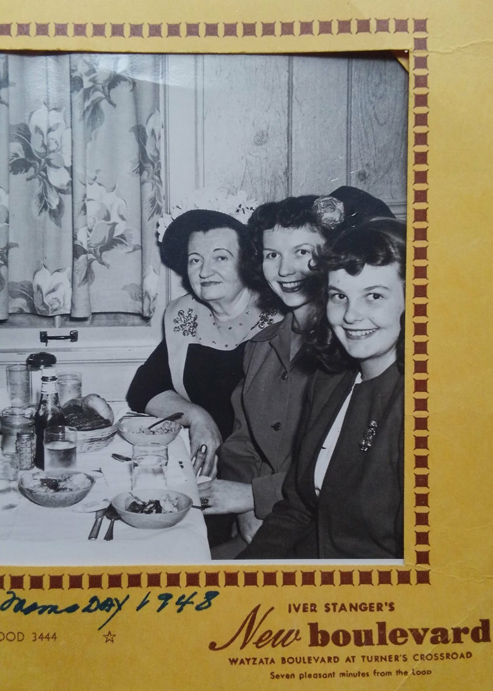
Photo courtesy Joe Chadwick
In 1949, Tommy McGovern, his piano and Orchestra, provided music for dancing every evening except the traditionally slow Mondays.
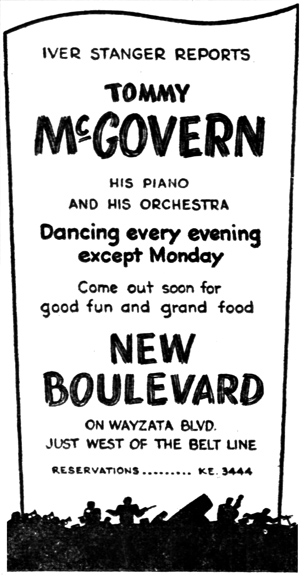
Minneapolis Star, Thursday, March 3, 1949
Harold E. Lynch and Norman Laswell applied jointly for a liquor license in August 1951. Laswell had worked at McCarthy’s in 1947.
In 1951, Norman Laswell was identified as the Manager. Stanger had moved on to be the manager of the food department of the Casanova Bar, Downtown.
Harold E. Lynch bought the property in about 1953.
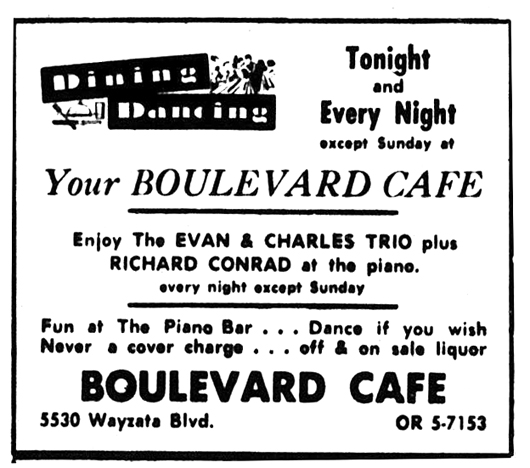
Minnesota Daily, July 19, 1956, courtesy Robb Henry
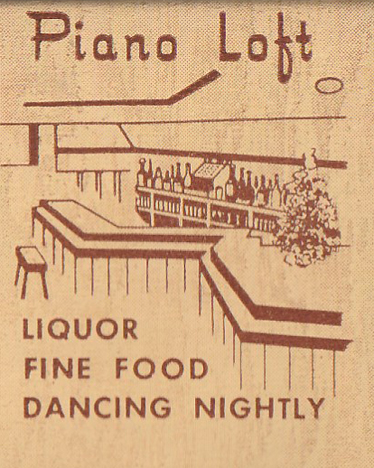
Matchbook courtesy Gordon K. Andersen

1958
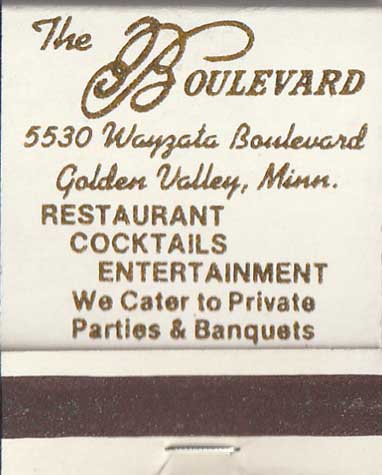
Boulevard Match Front, courtesy Gordon K. Andersen
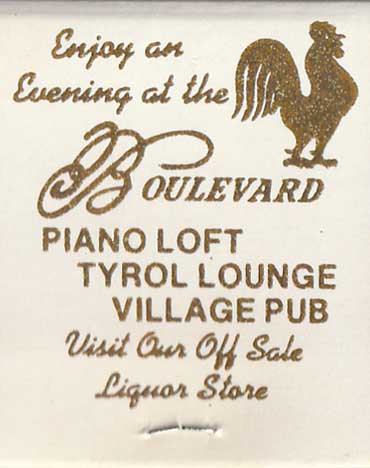
Boulevard Match Back, courtesy Gordon K. Andersen
In its prime, the Boulevard had an extensive menu. The picture below may be too small to see, but it covers a lot of ground.
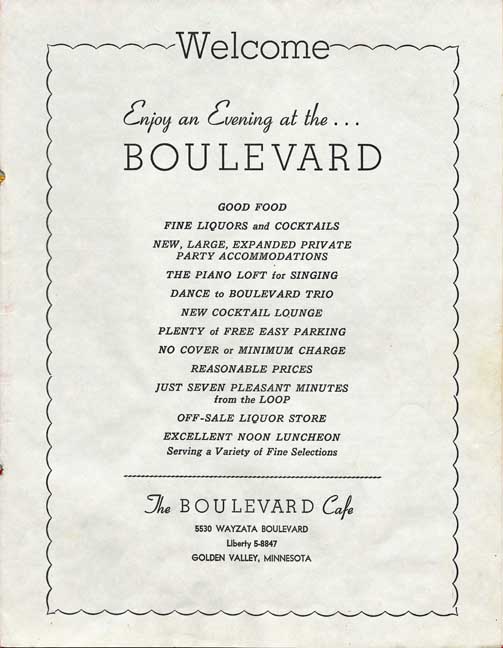
Menu courtesy Scott Smith
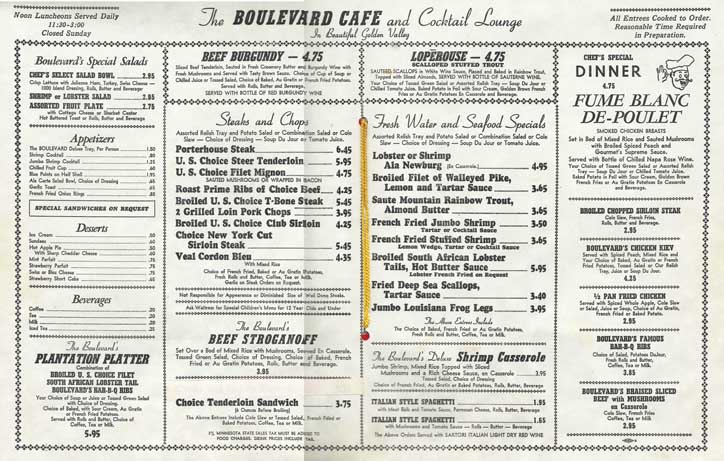
Menu courtesy Scott Smith
In 1960, Harold’s son Robert Lynch became a partner in the business.
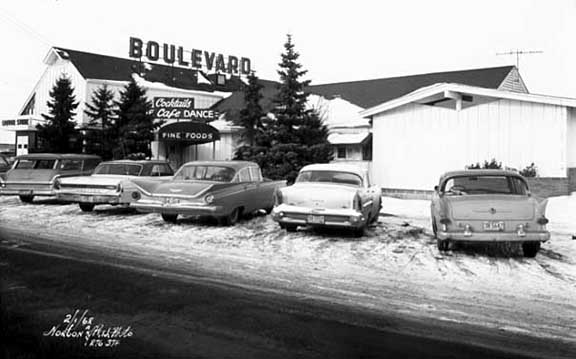
Boulevard – 1962 image courtesy Minnesota Historical Society
1963: “Ours is a humble place, but we think we have something to offer you.”
1967: dancing nightly to the Richard Conrad Trio.
1969: New Tyrol Lounge.
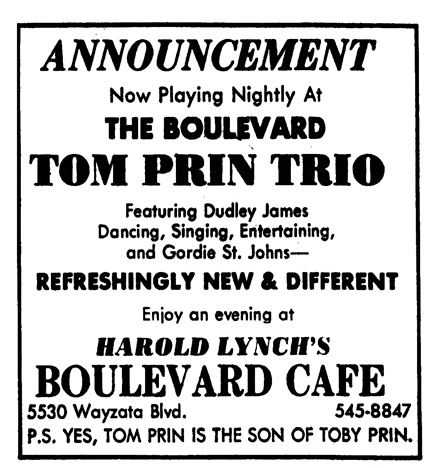
Minneapolis Star, August 13, 1971
1973: Dance to the Skylarks in the main dining room every Friday and Saturday night, and the “Carnegie Hall of Piano Bars,” frequently featuring my fourth grade music teacher, Judy Moen.
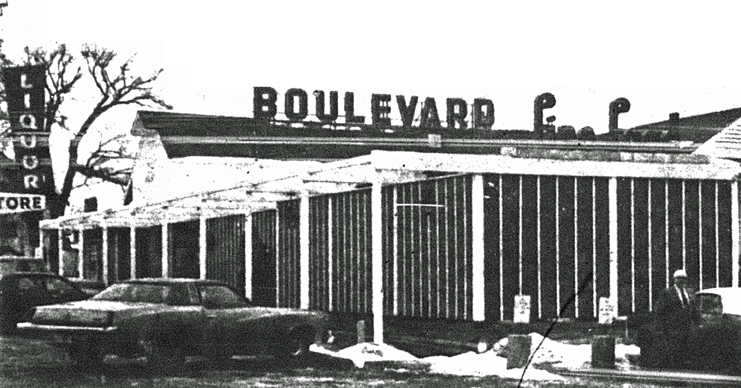
February 7, 1974
A salad bar replaced the dance floor in the main dining room in 1978. (Minneapolis Star, March 13, 1980)
Harold E. Lynch died on March 8, 1980.
The Piano Bar in the Loft was removed in 1980. (Minneapolis Star, March 13, 1980)
The restaurant was closed abruptly on July 2, 1982, and employees weren’t paid their final paychecks.
Contents were auctioned off in October 1985
The Boulevard was torn down for construction of I-394.
Save
The Boulevard Cafe was located at 533 Dupont Ave. near Sixth Ave. No. It may have been a converted store. Stebbins tells of a famous session in 1944 when some members of Duke Ellington’s band showed up after hours and jammed until 10:00 the next morning. Another night Ellington and Count Basie were in town on the same night. The jamming started at about 10:30 pm and so many musicians joined in that there wasn’t nearly enough room on the little bandstand. Stebbins quotes from Jim Bennett, “Jazz in the Twin Cities,” Twin Citian, Vol. VI, no. 7, March 1964, p. 17:
Along about midnight, the musicians took a break and the Boulevard was suddenly la Place Pigalle. Hookers got up and promenaded around the room in search of the night’s business. Peddlers stopped at your table to offer magic store novelties, loaded dice or “art” photos.
A black dwarf, less than three feet tall, raced through the room holding two flaming torches above his head. He squirmed up on the bandstand and swooped the torches around in great arcs to attract attention. The crowd quieted and he held one torch aloft, then plunged it into his mouth. A moment later he drew it out, still flaming… He pulled a sword from under his coat, saluted the audience, and slid it slowly down his gullet. The crowd applauded as he pulled it out…
There was a rush of tables when word went around that the Ellington and Basie groups were on their way… And then an interesting thing happened. Earlier preparations for the musicians’ heroes appeared casual in comparison with the arrangements now in progress. Heads craned to see who it was that merited such attention. After a few minutes a middle-aged Negro wearing glasses and a conservative dark suit was escorted to the seat of honor… There was no question of the position he occupied in the Boulevard’s firmament. He was a ranking star, the premiere personage…
His name was Fletcher Henderson…
In March 1945 proprietor Elmer Lewis and William L. Kelly were indicted by the Hennepin County Grand Jury on charges of purchasing stolen whiskey. They pleaded not guilty and were released on $1,500 bail. No details on the outcome.
This dance hall at 1929 North Rice Street in St. Paul saw some action over the years:
THE BOULEVARD DANCE HALL
Rosemary Ruffenach writes:
Family stories have my great uncle Ted (Theodore) Laber (1905-1982) and his sister Martha Laber operating a dance hall out of the building, likely sometime in the 1930s. I’m told that the land behind the dance hall was used as a dump for many years. Wrecked cars would just be rolled into the muck and would soon sink. Later on, Ted only allowed construction materials to be dumped, due to the smell arising from the brew. I am attaching a family photo from Ted’s collection. If you use it, please credit him and me. Thanks.
The Labers managed the establishment at 1986 Rice (Dean’s grocery, tavern and Red Crown gas pumps) until the mid 1930s. (The Dean’s establishment continues to exist, now as McCarrons Bar and Grill.) By 1938, the Labers had their own establishment at 1730 N. Rice, also a grocery store, tavern and Texaco station. In the 1980s the land was sold for the strip mall at Rice and Larpenteur. Subsequently, Laber’s Liquors continued to exist at that location, but the family no longer had a connection. In 2007, it was sold to Merwin Liquors, but the original name was maintained.)
Curtis’s Place? Cortls’ Place?
CLUB RESERVOIR
In September 1955 it went under new management and became Club Reservoir, featuring entertainment Fridays through Sundays.
The Boulevards of Paris Night Club was located at 1100 W. University Ave. near the Coliseum Ballroom in St. Paul.
It was operated by John J. Lane, and was described as a “well-known Prohibition spot” (Strib June 3, 1952) – don’t know what that means, but Lane was a Detective in the St. Paul Police Department, and a Ramsey County Commissioner from 1926 to 1934.
“Peg About Town” in the Minneapolis Tribune gave it a rave review when it opened in September 1929. The Northwest’s Smartest Night Club featured a complete dinner for $1.50.
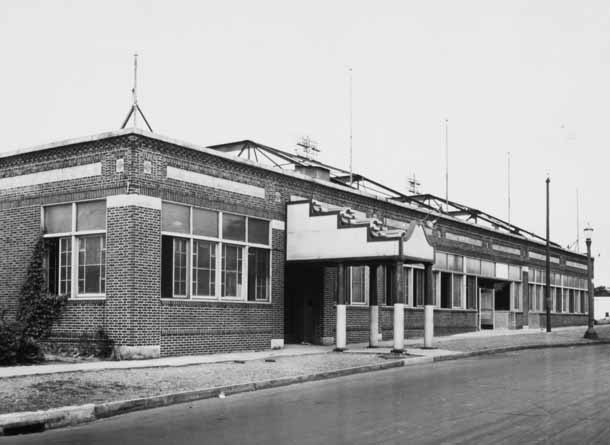
Boulevards of Paris, 1937. Photo Minnesota Historical Society
The place was known to be very elegant, and provided top-name entertainment to its patrons, such as:
- Fats Waller
- Benny Goodman
- Louis Armstrong
- Ben Pollack’s band made a lengthy appearance in the late 1920s and early ’30s with Jack Teagarden.
- McKinney’s Cotton Pickers
- With the end of Prohibition, Norvy Mulligan’s band played there frequently. (But that doesn’t make sense because it was out of business six months after beer was made legal…)
VANITY FAIR
For about a week (or maybe not at all) the night club was known as the Vanity Fair – This was at the end of September, beginning of October 1933.
SILVER DIME
Its next iteration was the Silver Dime, which was advertised between September 1934 and mid-June 1935. Whether there was something in between the Vanity Fair and the Silver Dime is unclear, but the the Silver Dime is advertised as “Formerly the Boulevards of Paris.”
By 1949, 1100 W. University Ave. was the site of a National Food Store.
The Bow and Arrow Club was located just north of First Street in Mendota, beginning in early 1941.
Stebbins:
In the early 1950s the Bow and Arrow became a modern jazz stronghold featuring the Bob Davis Quartet and Rook Ganz’s band. There were also Sunday afternoon sessions which primarily attracted local musicians.
A couple of years later the owner invited Doc Evans to take over in an attempt to bring Dixieland back to Mendota. For the occasion the name was changed to the Rampart [Street] Club.
The Rampart Street Club was not successful, and a few years later it again became the Bow and Arrow Club, occasionally featuring a jazz group.”
The Bowery Tavern was located at 9400 – 6th Ave. No. (Highway 55 and County Road 18) in Golden Valley. The address today would be 9400 Golden Valley Road.
Note: There were other Bowerys, in particular one at 9 Washington Ave. No. in Minneapolis.
This one in Golden Valley was in place as of June 1939. It was strictly a tavern, with 3.2 beer and setups.
In 1952, the Golden Valley Village Council approved the transfer of the Bowery’s liquor license from Chester Tomchek to an employee, Frank J. Gracyasz. (Minneapolis Tribune, February 6, 1952).
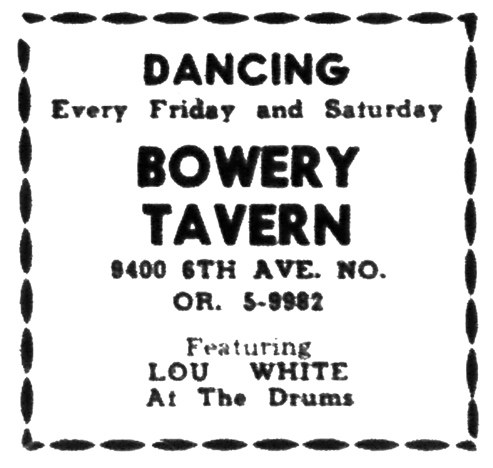
North Hennepin Press, August 20, 1953
In 1955, the Bowery figured in an inquiry about the fitness of Police Chief Al McGinnis to remain on the force. Testimony of a temporary policeman was that McGinnis, then off duty, called the temp and ordered him to get a bottle of gin from the Bowery and bring it to the address of his girlfriend – in the Village squad car. (Minneapolis Star, September 13, 1955) McGinnis was discharged on 11 counts of malfeasance, and he appealed the action in a court case with a jury. The jury found that he should be reinstated, but the Village Council took the case to the Minnesota Supreme Court. In the meantime, McGinnis was fined for doing electrical wiring without a license…
In November 1955, a church got a permit to build within 400 feet of the bar, which wouldn’t have been legal the other way around. (Minneapolis Star, November 16, 1955)
In 1959 there was live music and dancing on Friday, Saturday, and Sunday nights.
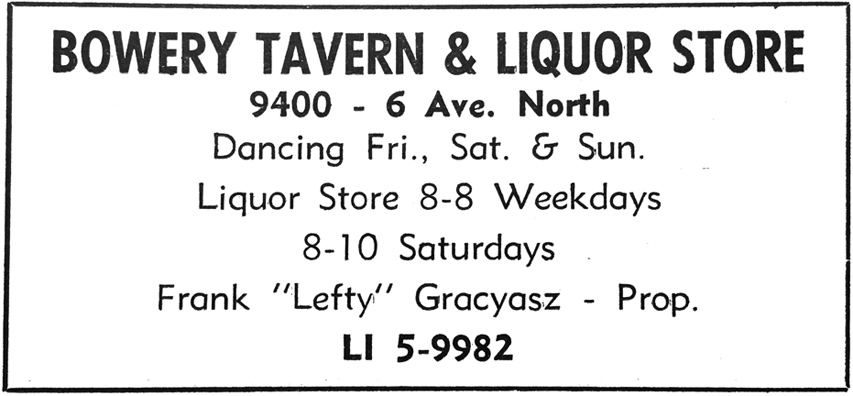
Image from the 1959 Golden Valley Directory, courtesy Crystal Boyd
On June 17, 1959, owner Frank “Lefty” Gracyasz sold a pint of vodka, a fifth of vodka, and a fifth of whiskey to a 17-year-old from his adjacent liquor store. The teenager then took a friend’s car and got into an accident on Glenwood Ave. and Glenwood Parkway. On July 6, 1959, despite his claim that he did not even sell one of the brands, Lefty was convicted in Golden Valley Justice Court of selling liquor to a minor. He appealed his conviction in Hennepin County District Court, but lost and was sentenced to a $100 fine or 30 days in the workhouse. He paid the fine. On December 15, 1959, Lefty lost his off-sale license for the liquor store, but kept his 3.2 beer license for the tavern. The Village Hall was packed for the hearing, and boos went up as Lefty’s license was revoked. (Minneapolis Star, December 16, 1959)
Lee Lofstrand was the new owner as of May 26, 1960.
Joe LaRocque was identified as the owner in a report of a robbery on November 15, 1961.
VFW
By 1965 the building was home to Veterans of Foreign Wars Post 7051.
A new building replaced it in 1976.
This page covers two venues owned by the same man, Boyd Houser. Additions, corrections, photos, and stories welcome: contact me!
BOYD’S 622 BAR
Boyd’s daughter Carolyn Houser Talberg reports on Facebook that for years her dad had a small bar on the NE corner of Plymouth and Lyndale. The Minneapolis Department of Housing and Redevelopment wanted that land to build low income housing. They gave him land on the Mississippi River for a dollar. “What a shame, as that old bar was replaced by what is now old shambled houses. That old building was so cool!
BOYD’S ON THE RIVER
The new Boyd’s was located at 1315 N. West River Road. Carolyn goes on to say that “Boyd’s on the River started out as a supper club and my brother Michael convinced our Dad to turn it into a rock and rock club!” XL5 was a frequent house band. The club featured two bands, one upstairs and one downstairs.
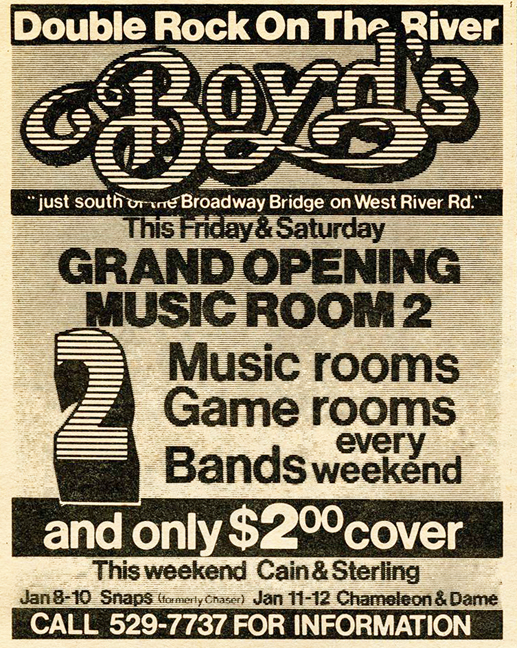
1980, Courtesy Sandra Kenyon
The undated flier below indicates a diverse musical identity, with Country, Rock, and New Wave mixed in.
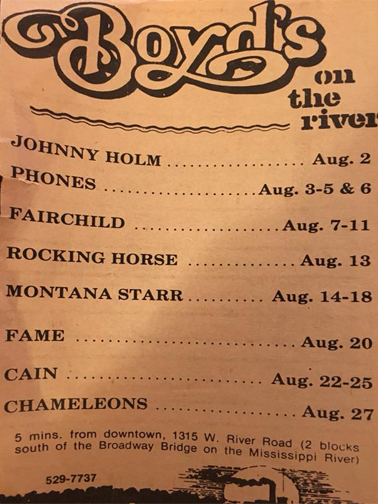
Courtesy Sandra Kenyon
Boyd’s had a particular penchant for paraphernalia, which I love!
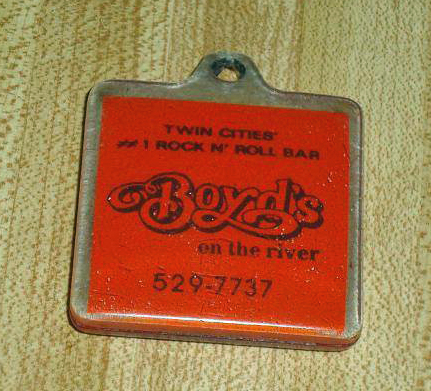
Courtesy Kevin Rolph
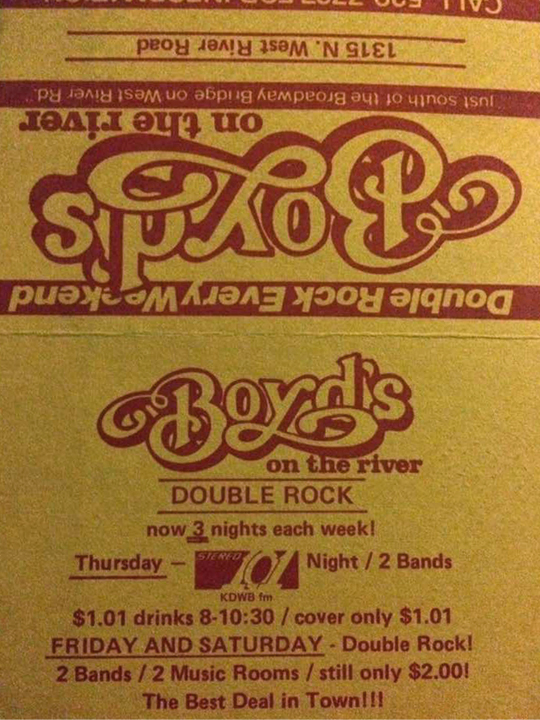
Courtesy Sandra Kenyon
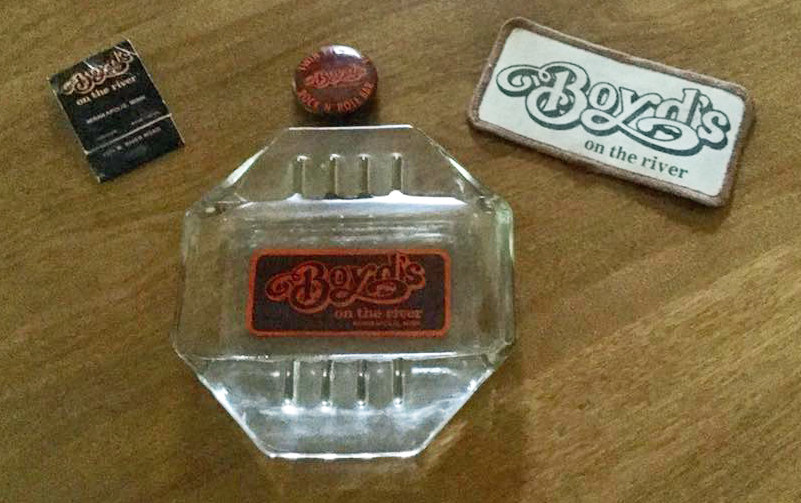
Memorabilia from Boyd’s, Courtesy Carolyn Hauser
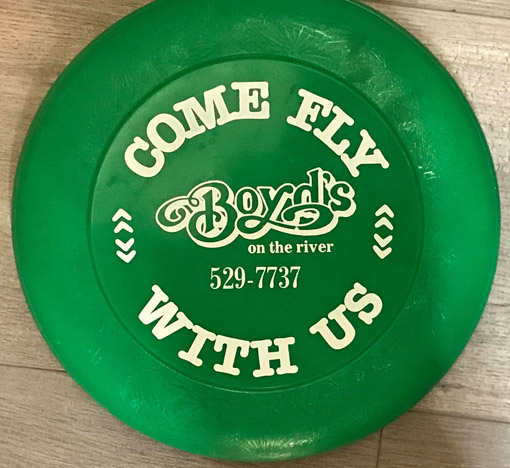
Courtesy Sherri Nitti
THE T-SHIRTS OF BOYD’S ON THE RIVER
Apparently Boyd Houser put out some pretty popular T-shirts, as two different people have sent me images of their treasured barwear from years ago. The first comes from David Kinkaid, as modeled by his daughter. Both are cute!
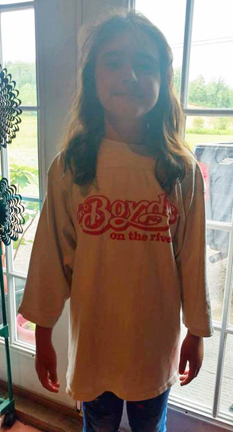
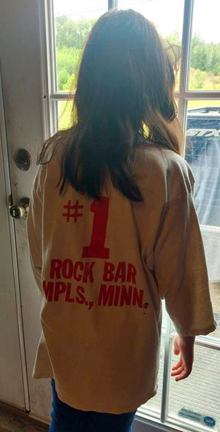
Then Todd Erickson shared images of his Boyd’s Ape T-Shirt with me, with this story:
Back in the old days, a friend and I headed to the TCs from Rush City to check out some bars w/music. Somehow we ended up at Boyd’s – I remember it was just packed and we could hardly move. It was wild and awesome for two country boys in the big town. Never thought about it then but now I wonder about the fire code on amount of people there? That night Boyd’s was giving away T-shirts, but all they had left was mediums and I took a X-large back then. But it was so cool looking I took the medium. Boyd Houser did not monkey around with making that elaborate T-shirt. It just sat in my dresser drawer for years. I moved to Taylors Falls a few years ago. I got into hanging the clothing my Mom kept all these years of us kids, especially T’s on my walls and now the items have started to go on the ceiling.
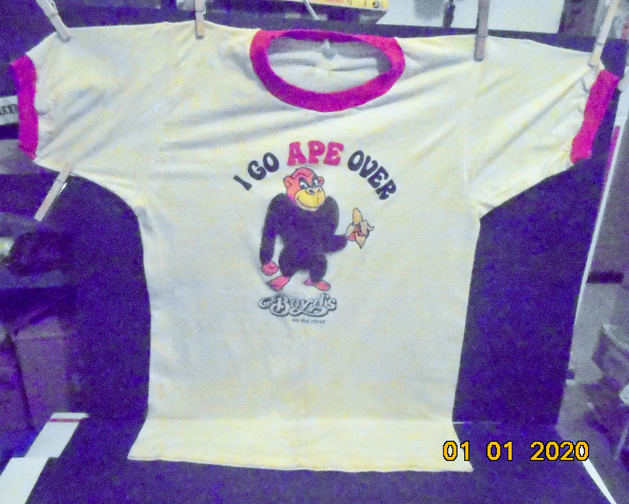
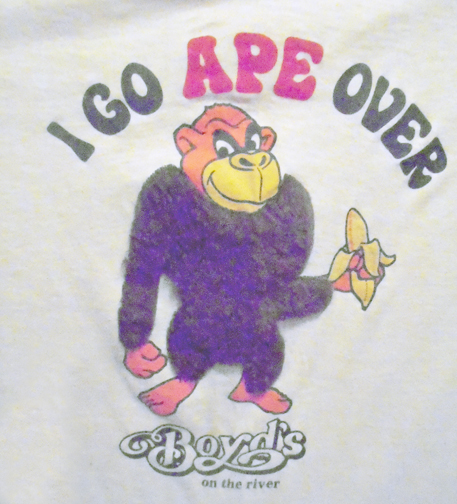
Brady’s Pub was located at 604 Hennepin Ave., on the site where a sandwich shop and two different restaurants had been.
The first listing in the Minneapolis papers was an ad for a young lady to play piano in the evenings at Brady’s Bar. This was on May 10, 1935. In 1936, the bar sponsored a bowling team. “Central Lanes” was apparently in the basement.
A 1938 list of renewals of liquor licenses shows Harry H. Clark doing business as Brady’s Bar and the Coconut Grove. The latter was apparently on the second floor.
Ads for the Coconut Grove appear in 1937, and the address is just listed as 6th and Hennepin. The address for the licenses are listed as 3 North Sixth Street and 602 – 604 Hennepin Ave.
In 1940, Walter Winchell reported that Brady’s Bar introduced “miniature picture machines” to the area, manufactured by Auto-Pix of Chicago. For a nickel you could get 3 1/2 minutes of entertainment on a 3′ by 4′ screen. These may have been early versions of Soundies, popular in bars from 1940 to 1947. (Minnesota Times-Tribune, July 25, 1940)
When the War came, news of the bowling team was replaced by ads for help, as otherwise plentiful workers went off to the military. Some ads asked for Porters – Colored or White.
On August 13, 1945, owner H.H. Clark was called in by the Hennepin County Grand Jury for questioning with regards to legal ownership of liquor licenses. Two City Aldermen were also called. Clark was to be questioned on the 17th, but the grand jury was told that he was on vacation and could not be located. A subpoena was issued on August 28 for the missing Clark.
A St. Paul man attracted the attention of 300 to 400 people when he was bounced from Brady’s three times. On the fourth attempt he was taken to jail. He put up a fight and was charged with disorderly conduct. (Minneapolis Daily Times, June 22, 1946) Officers also testified that the man had a gun on him. The judge fined him $25 and stayed it for a year.
On Sunday, July 10, 1949, Harry Clark, identified as president and manager of Brady’s Bar, underworld figure Tommy Banks, and their wives were out on Clark’s 30 foot cabin cruiser on Lake Minnetonka when it blew up and burned to the water line. The gas tank had just been filled, and firemen said a spark from the motor may have ignited fumed that had collected in the bilge. (Minneapolis Tribune, July 11, 1949) Despite the two men’s friendship, Tommy later sued Harry for his injuries. (Minneapolis Tribune, August 12, 1954)
In 1950, Harry Clark (and Tommy Banks) were involved with streetcar-to-bus scandal that rocked Minneapolis. True to form, when it came time to be questioned, Clark could not be found. (Minneapolis Tribune, October 18, 1950)
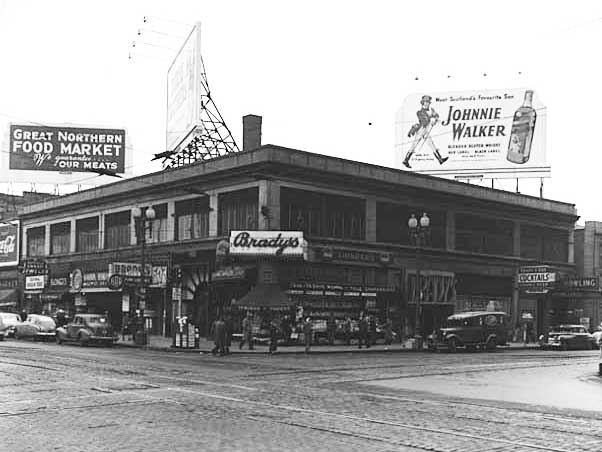
1950 photo courtesy Minnesota Historical Society
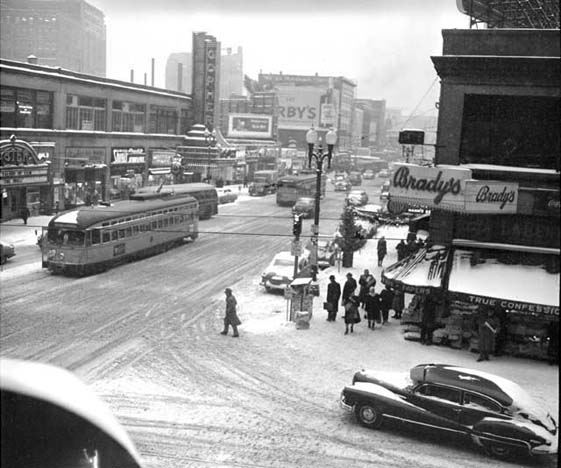
1951 photo courtesy Minnesota Historical Society
In January 1952, Charles Halloran became manager of Brady’s while Clark vacationed until the spring. Then Halloran would return to the Blue Goose Inn, in Garrison, Minnesota, where he had been manager for several years. This article revealed that the license for Brady’s was held by Brady’s Bar, Inc., 3707 Grand Ave. The occupant of that apartment was Mrs. Lumina Brancheau. Phillip Brancheau and Harry Clark signed the surety bond for the bar. One of the incorporators of Brady’s was Mark C. McCabe, who was also an incorporator of the Blue Goose. The others were Holleran and Mrs. Reta Banks, wife of Tommy Banks. (Minneapolis Tribune, January 5, 1952)
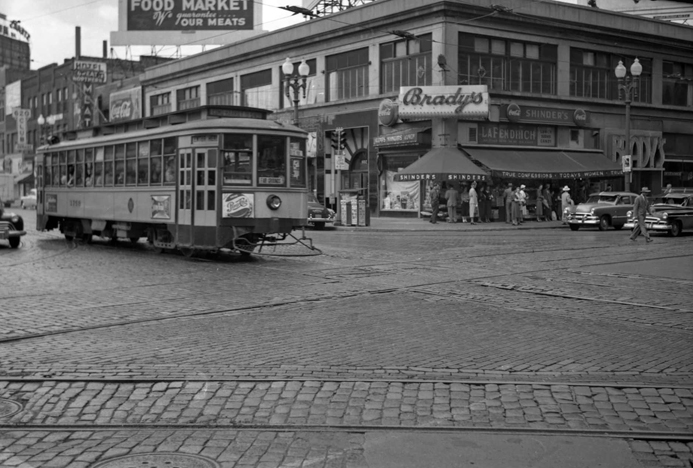
1952 photo courtesy Minnesota Streetcar Museum
On January 6, 1953, Brady’s Bar made the headlines when John Card, son of local broadcaster and comedian Clellan Card, was killed in a car crash. His friend was driving, and admitted that he had had a few drinks at Brady’s. The driver was charged a fine, but the City Council ordered an investigation and threatened to pull the licenses of the bar. (Minneapolis Star, February 27, 1953) A hearing was held on March 11, 1953, but the matter was tabled.
On May 21, 1954, a fire in the Knights of Columbus clubrooms on the second floor did damage to the building. (Minneapolis Star)
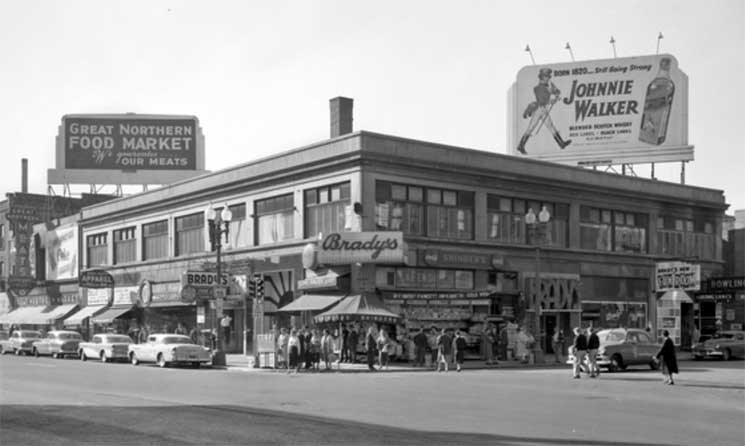
1955 photo courtesy Minnesota Historical Society
In 1956, more mayhem began at Brady’s, where Donald A. Trinko was introduced to Mrs. Gladys Duprey. The next morning, Gladys was dead in a room at the Leamington Hotel, and Trinko was telling his wife “I think I killed somebody.”
In 1959, Cedric Adams reported that “Brady’s on 6th is still pitching western with the Rhythm Rangers quartet plus Texas Bill Strength …” (Minneapolis Star, April 13, 1959)
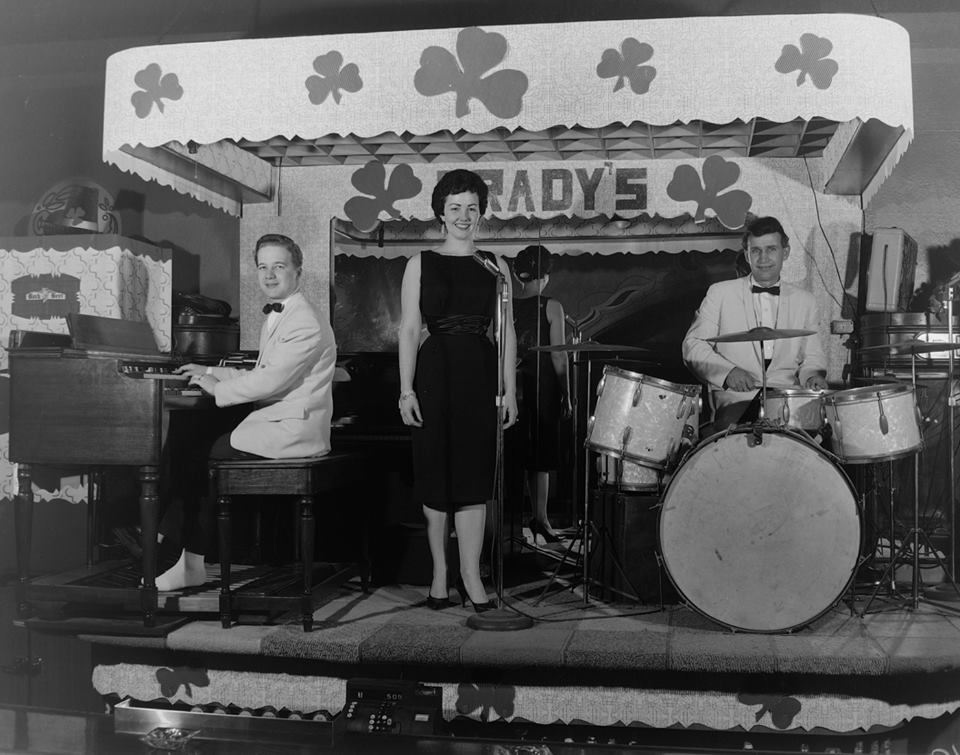
Brady’s Lounge, March 2, 1961
JAZZ
One report says that Dixieland was being played in the late ’50s and early ’60s. This comes from the obituary of Lloyd G. Smith, whose band the Lloyd George Quintet, played at Brady’s Bar. (Minneapolis Tribune, August 5, 1987)
By at least January 1962, Brady’s had become a jazz venue, hosting the Hall Brothers Dixieland Band.
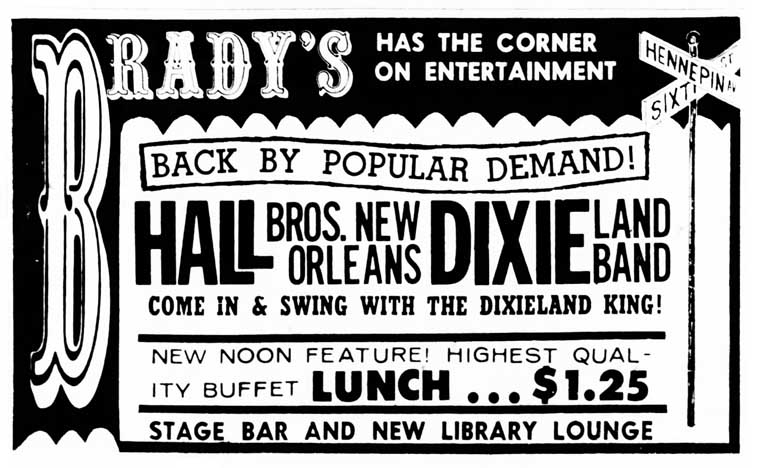
Minneapolis Star, August 30, 1963
Butch Thompson posted the photo below on Facebook:
During the early ’60s, I played clarinet at Brady’s on 6th and Hennepin with the Hall Brothers Jazz Band. Here’s a photo of us as we left work on New Year’s Eve, 1964. This was our last gig there — we’d been given our notice a few weeks earlier. BTW I was under the legal drinking age — 21 — but we rigged something up with a letter from my parents. Left to right: Don “Doggy” Berg, drums; Charlie DeVore, cornet; Stan Hall, piano/leader; Mike Polad, banjo; Butch Thompson; Bill Evans, bass. Absent: Russ Hall, trombone. Photo by Dave Pfankuchen. — with Don “Doggie” Berg, Charlie DeVore, Stan Hall Piano/Leader, Michael Polad and Bill Evans.
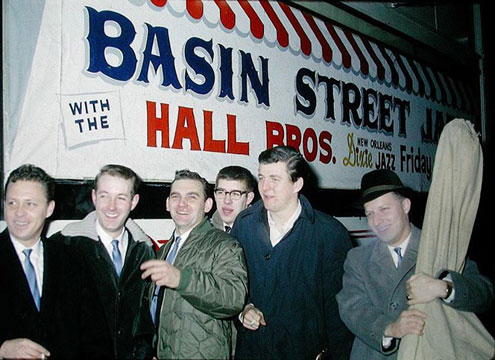
1964 Photo courtesy Butch Thompson
In 1968, Brady’s was back to specializing in Country and Western music.
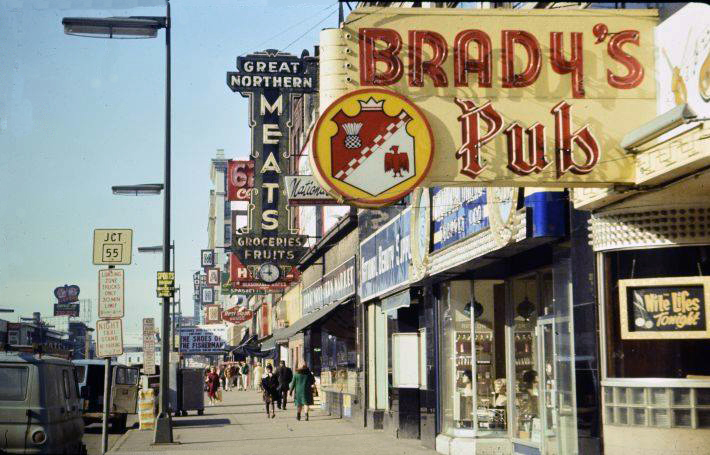
1969 photo courtesy Hennepin County Library
In 1970, an expansion of Shinders news stand extended into space formerly occupied by Brady’s Bar. (Minneapolis Star, December 30, 1970)
In February 1971, Barbara Flanagan of the Star reported that Brady’s would be getting a new facade.
BRADY’S PUB
The bar became known as Brady’s Pub in about 1974.
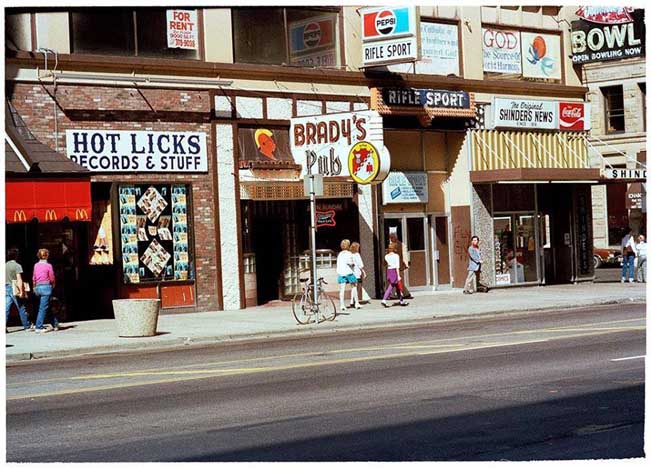
September 1983 photo by Barb Economon
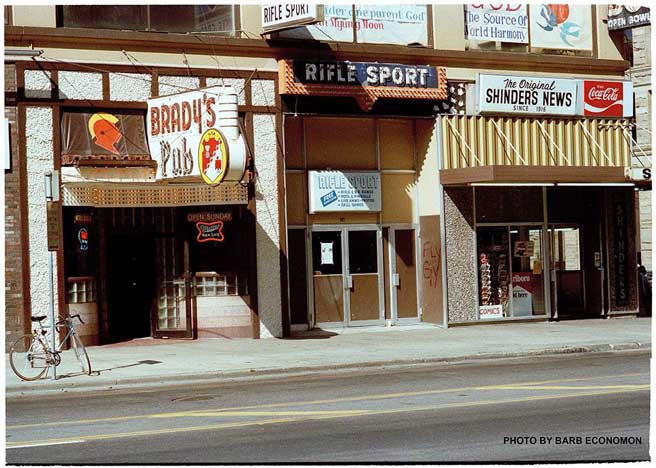
September 1983 photo by Barb Economon
In 1988, now called Brady’s Pub, the bar received a five day suspension for drug trafficking and gambling. This was an especially severe penalty. (Minneapolis Tribune, February 13, 1988)
The Break was a folk spot at Oak and Washington in 1962.
The Bridge Square Tavern was located at 209 Nicollet Ave., in the heart of Skid Row in Downtown Minneapolis.
Bridge Square was where Hennepin and Nicollet Avenues came together at the oldest part of the City, and where approximately 3,000 transient men lived in cheap hotels on pensions from working on railroads, lumber camps, and other rough-and-tumble jobs.
The area was one of only a few in Minneapolis where bars that sold liquor were allowed, according to the Patrol Limits ordinance, so there was an inordinate number of bars, taverns, and liquor stores in the area.
THE BUILDING
This particular building goes back to before 1888. Demolition notes give it a footprint of 21 x 119 x 38 ft. It was a 3-story brick building.
The upper floors were as a 15-room lodging house for men called (at least in the ’20s, ’30s, and ’40) as the La Salle Hotel. One of its early owners was Charles J. Budde.
Early uses of the ground floor are usually noted as a store, a saloon, or a lunch place.
On April 29, 1924, there was a fire in the basement that threatened to destroy the building. The newspapers reports told us that the hotel was called the La Salle and that the first floor held the Eureka Lunch.
From 1924 to 1925, a man named Hugo E. Blair had a Pool hall.
In 1926, W. Kalinsky had a City permit for soft drinks and lunch, pool.
From 1928 to 1932 it was Moore’s Restaurant, owned by T.J. Moore. From August 1929 to 1932 it was simultaneously for sale and advertising for waiters.
By February 1933, Einar and Emma Smith owned the Smith Restaurant.
THE BRIDGE SQUARE BAR
In April 1934, Harry Sobelman and Bessie Feldman received an on-sale liquor license and became the co-owners of the Bridge Square Bar. Bessie’s husband John was a bartender, but couldn’t be an owner because of the year-long stint he did at Leavenworth for a Prohibition violation in 1930. In May 1934, Harry and Bessie got permits for a restaurant, cigarettes and soft drinks, non-intoxicating malt liquor (on and off).
The joint was jumpin’ in 1935, apparently, when the Bridge Square Bar showed up in Walter Winchell’s fake column about where to go in the Twin Cities. I mean, has WW ever heard of Minneapolis? But someone wrote this copy in his unique patter:
The band at the Bridge Square Tavern is among the tops when it comes to torrid tootling – and when resting why not eat – and wel – well, drop in some evening when you’re out – and take a look – and a bite – and a dance. Mr. and Mrs. You-Know will very probably be there. (Minneapolis Tribune, November 15, 1935)
In February 1937, proprietor Harry was convicted for allowing employees to let a 16-year-old frequent the bar. He took it to the State Supreme Court and lost.
Probably as a result of the court case, in March 1937, the bar’s liquor license was transferred from Harry and Bessie to just Bessie. Bessie also got licenses for tavern, dance hall, restaurant, cigarettes and soft drinks.
For some reason the proprietor’s name in yet another crime story was given as Ben Feldman.
In November 1947, Bessie’s beer and liquor licenses were transferred to the Fraternal Order of Eagles, Minneapolis Aerie No. 34, 325 Second Ave. So.
And the Bridge Square Bar went under. In its 13 years, the Bridge Square Bar had more fights, robberies, sluggings (that was a technical term used then), beatings, and people with razor blades in their pockets to fill a book. It may not have been the worst place in the Gateway, but something about it made guys mad. And yet, there must have been women – there was music, there was dancing – even Walter Winchell said you could take your lady friend for a night out at the Bridge Square.
BRIDGE SQUARE TAVERN
November 1947 – Bernard Feitelsohn, a former bartender at the abandoned Bridge Square Bar, applied for a beer license. At first it was opposed by his local Alderman, but since it would just be a beer tavern, Bernard knew the territory, and he promised to clean the place up, the permit was approved.
One thing Bernard didn’t have was a dance hall license: on June 28, 1950, Bernard was charged with allowing dancing without one. He was also in trouble for serving minors. While visiting the Tavern, the morals squad took in seven people for drunkenness. A photo of the Unfortunate Seven being herded into the paddy wagon graced the Minneapolis Star the next day.
In September 1950, Bernard was caught by Federal Agents of the Department of the Interior, selling beer to Indians. This was no longer against Minnesota law but was still a Federal offense. On February 13, 1951, he was sentenced to six months in the Workhouse and fined $250. (Minneapolis Tribune, March 7, 1951) Bernard lost his beer license on March 9, 1951.
In 1951 the new proprietor was Lige Udell. The new license was granted under protest.
In March 1956, Sam E. Silverman was the proprietor. In June 1956 the Tavern was given a 10-day suspension by the court because a waitress had been found guilty of keeping liquor and wine at the 3.2 beer place.
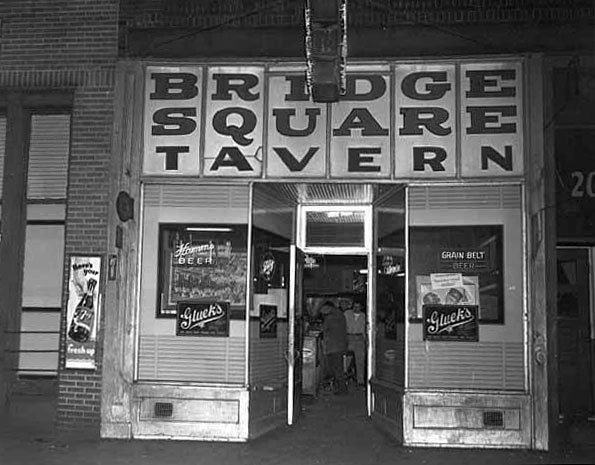
Photo (@1947-1960) courtesy Minnesota Historical Society
In June 1959, the owner was identified as Mrs. Kathryn Chester.
DEMOLITION AND REBIRTH
The building was part of the ambitious Gateway Redevelopment Project, where 20 blocks of mostly old, obsolete buildings were torn down by the City of Minneapolis, with plans to rebuild newer and better buildings and infrastructure and resettle the 3,000 residents of the area. The demolition part of the plan was carried out, and some building was done, but to this day, some of the land that was cleared has remained barren.
In the case of the Bridge Square Tavern, the fixtures were sold in July 1960, and the demolition permit was pulled in October 1960. And the geography of the streets has changed, but if I’m reading the map right, in its place stands what was originally the Northwestern National Life Building, the symbol of what was supposed to be the New Gateway.
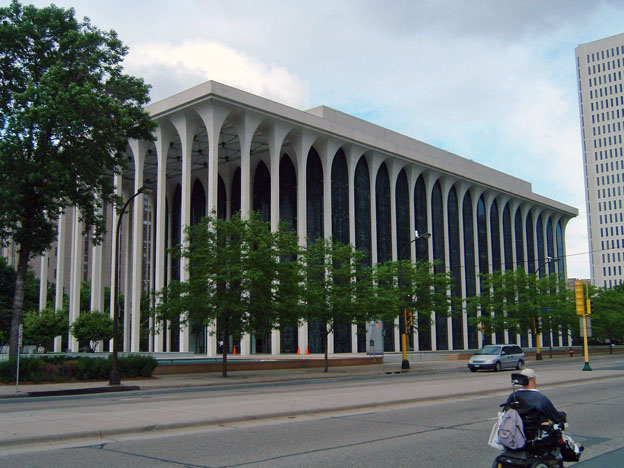
Please see Rainbow Bowl
702 Olson Memorial Highway, 1948. Good Food – Latest Records – Arcade Games – Make Your Own Record.
This appears to be a music venue inside Brighton Lanes Bowling Alley. Babe Wagner’s name is associated with it, but he was really a jazz/polka musician, and during that time he was mostly playing the Bel-Rae Ballroom. Other than this one ad, I didn’t find any other evidence of it.
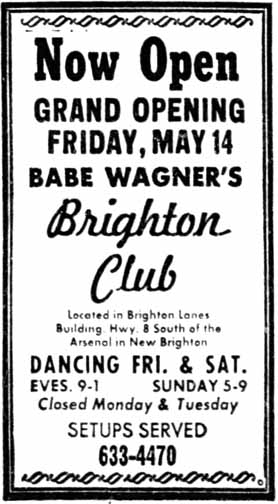
Minneapolis Tribune, May 9, 1965
The Broken Drum was located at 327 Cedar Ave., Minneapolis
This was a coffee house/jazz venue, from 1966 to 1967.
Allan Holbert of the Minneapolis Tribune described it in an article about Coffeehouses on July 3,1966:
Owner of the Broken Drum, a jazz-and-folk music coffeehouse at 427 Cedar Ave. is Mike Fagin, a teacher who works with children with hearing handicaps at Agassiz School. The Drum is decorated with paintings and sculpture that have been loaned by student artists. In addition to a variety of coffees, the Broken Drum offers such exotic cold drinks as a “Charlie Parker,” a “One Step Beyond,” and a “Crippled Wing.” Whenever the Broken Drum’s folk or jazz performers aren’t on stage, customers can make selections from a juke box that includes jazz and classical music, plus a recording of a “Lone Ranger” radio show. The Broken Drum is open until 2 am Thursday through Sunday, but the entertainment, because of a city ordinance, stops at 1 am.
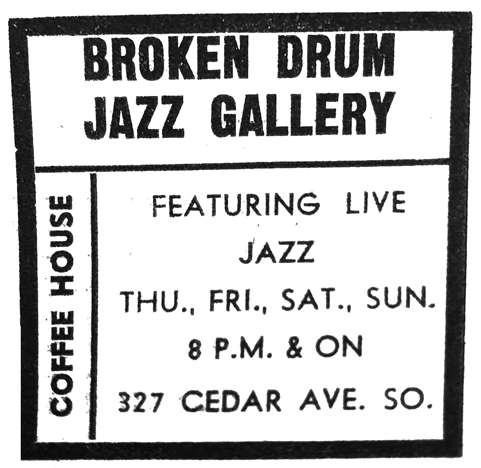
Undated but early ad, Minnesota Daily
An early and frequent performer at the Broken Drum in 1966 was folklorist Maury Bernstein.
Thanks to Alan Slacter, researcher extraordinaire, we have a photo of the Broken Drum – note broken drum in the window!
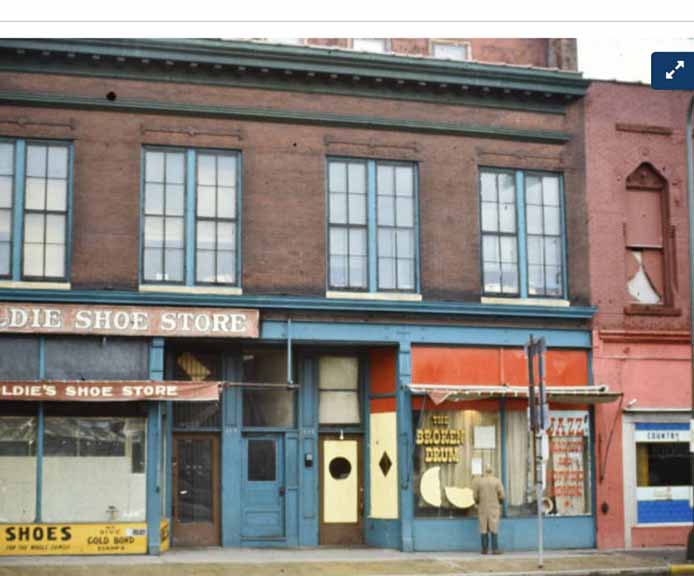
Broken Drum at right, February 1966. Photo courtesy Hennepin County Library
The Bronco Bar was in Chanhassen.
“Bulletin: Frontier in Chanhassen Announces the Opening of the Bronco Bar and Frontier Wines and Spirits (Package Store) For Your Convenience and Pleasure. MORE TO COME. Just the Beginning of a Great New Complex. Open July 19, 1968.” (Ad in Minnetonka Sun) In the mid-’70s we would endure the country band and then dance our asses off to the rock they played during the intermissions.
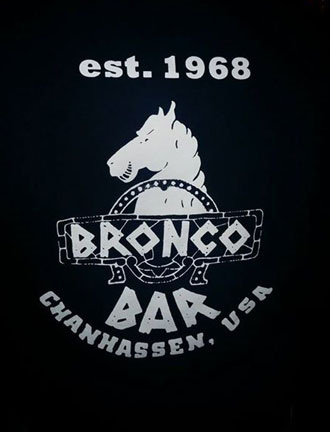
Highway 13, Prior Lake. In August 1969 the bands featured included Gary Kent, Guy DeLeo, Lexie Johnson and Buddy White.
There appear to have been a lot of Brown Derbies in Minneapolis and St. Paul, not to mention the ones in New York and Hollywood. And Austin and South Dakota and Fargo.
340 MAIN AVE., ST PAUL
The ad below, and a mention of a Brown Derby Night Club in St. Paul in October 1932, are the only hints of this site. 1932 and 1932 were during Prohibition, so presumably no liquor was served. Keep in mind that I have no access to the St. Paul newspapers.
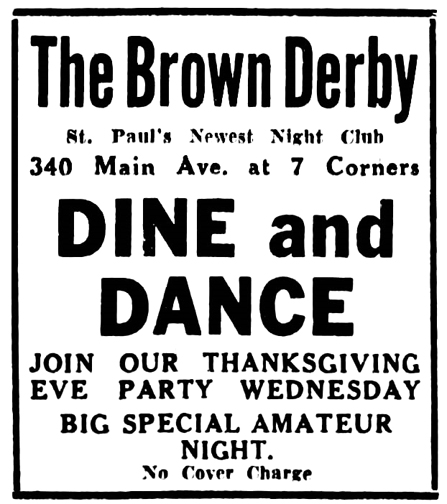
Minneapolis Star, November 24, 1931
BROWN DERBY FOOD SHOP, MINNEAPOLIS
In December 1935 there was a Brown Derby Food Shop, where poor Phoebe Leonard ordered her breakfast and then dropped dead. That one was located at 918 Nicollet Ave. in Minneapolis.
BROWN DERBY CAFE
This Brown Derby Cafe was located at 50th and France, right next to the Edina Theater.
This location, at 3915 W. 50th Street, was originally called Bill and Earl’s Brown Derby Cafe in 1936. It soon changed to Bill and Lee’s Brown Derby when Bill Olson bought out Earl Oxboro. Bill and his wife ran it until 1957. (Minneapolis Tribune, November 15, 1980)
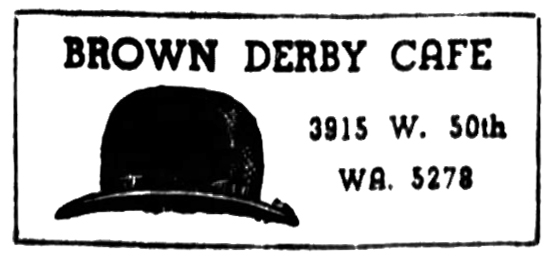
Minneapolis Tribune, February 4, 1940
In January 1942, a slot machine there was listed as belonging to proprietor William A. Olson. In 1943, Olson was fined $25 for serving part Oleomargarine without notifying his customers that it wasn’t all butter. In April 1943, Olson was fined $75 for maintaining a nuisance after sheriffs picked up a slot machine at his place. In December 1947, the Tavern Inspector arrested Olson for selling beer to a minor for the third time that month. He called it “a regular hangout for minors.” Olson was fined $50. Ads continued until September 1960.
Obituaries appeared for Kermit S. Dahm, who died October 30, 1960, and Olson, who died January 15, 1961, both listed as the owners of the Brown Derby.
The Edina location continued into the sixties. One Will Jones article mentioned old bands like Frank and Milt Britton’s Brown Derby Band (December 23, 1964).
The fixtures of the 50th and France Brown Derby were auctioned off on December 29th, 1966.
CHICAGO AVE.
A second (or new) Brown Derby Bar was located at 1603 Chicago Ave. So. in Minneapolis, as evidenced by the report of a fire in the building at 12:15 am March 25, 1965. The blaze caused about $5,000 in damage and outed about 30 customers. There were four apartments in the rear of the building. (Minneapolis Star and Tribune) In August 1965, Rudolph Nassif was identified as the owner of the Brown Derby Bar.
ST. PAUL – 567 STRYKER
Another Brown Derby was located at 567 Stryker Ave. on the West Side of St. Paul (just south of George Street). A realtor page says that the building dates to 1900.
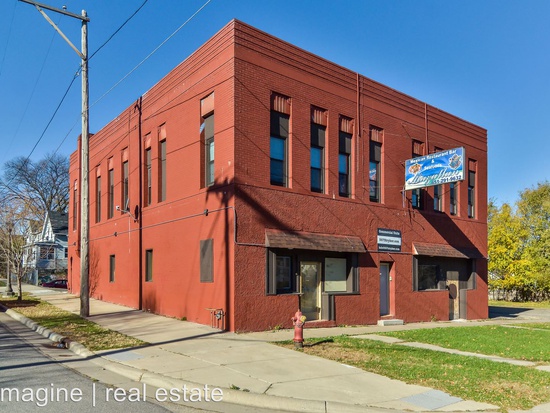
The building in about 2018
CURLY’S DUTCH ROOM TAVERN
In 1942 to at least 1956, the location on Stryker was Curly (Moren’s) Dutch Room Tavern.
THE BROWN DERBY
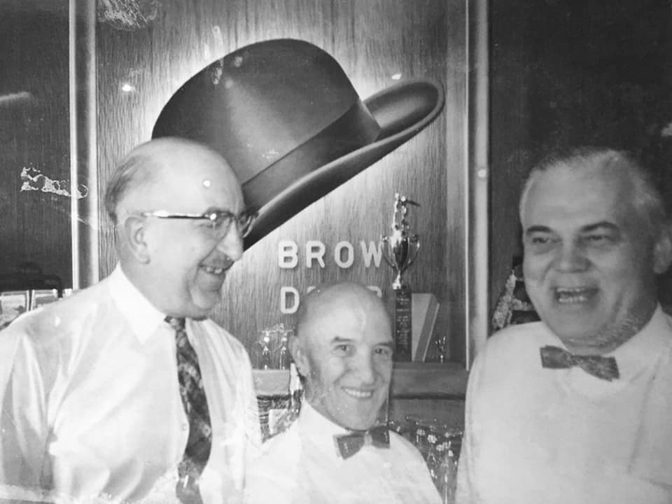
Owner Maynard; Bartender Jim Lewis; Chef Odie. Courtesy of Jim Lewis’s granddaughter, Janelle Lewis
Here are some of what I call Facebook Facts; thanks, folks!
Joe Bonasera was a bartender there too, says his niece.
Rich Thomas bought it in about 1963.
On December 3, 1967 the bar on Stryker advertised that it was remodeling, and wanted to sell its 44 ft. bar and backbar, 18 booths, 9 sets of tables and chairs, and coatracks. (Minneapolis Tribune).
By December 1968 it was the Brown Derby Lounge, as evidence by the report of a foiled robbery attempt. (Minneapolis Star, December 23, 1968)
The matchbook below indicates that the owners were Don Orth and Ken Anderson. Anyone related to these guys?
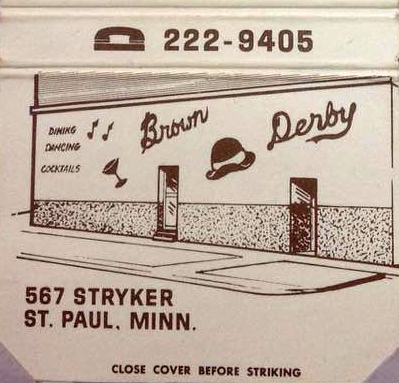
From the collection of Mark Youngblood
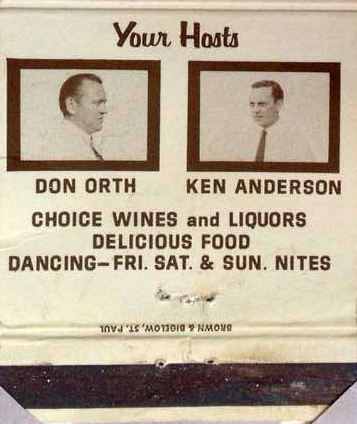
From the collection of Mark Youngblood
Back in the ’60s there was live music on Friday and Saturday nights. “ Igor and his band used to come in with accordion music and got lots of people dancing!!” Love it!
In February and April, 1986, St. Paul vice officers observed several Brown Derby patrons received cash payoffs from the bartender after accumulating points on video poker games. The video games were legal, but receiving money from playing the games were not. Illegal gambling was found in a raid in September 1986. (Minneapolis Star and Tribune, November 6, 1986) Louis Wenner, who ran the business from an apartment, pleaded guilty. (June 9, 1987) In September 1987 the St. Paul City Council voted to suspend the bar’s liquor license for two days or fine the owners [listed as Thomas Enterprises Inc.] $200 for conducting illegal gambling in the business. As reported by Minneapolis Star and Tribune writer Chris Ison on September 24, 1987.
In 1992, John Bream described it as a hard-to-find neighborhood bar; music was a regular feature.
In the early morning of January 1, 2000, a fight broke out among friends at the Brown Derby. They moved to a New Year’s party on Wyoming Street, and one of the men came back and shot into the crowd at the party. Four men, including the suspect, were treated for bullet wounds.
It was still going in 2003.
It is no longer in business, replaced by a tobacco shop.
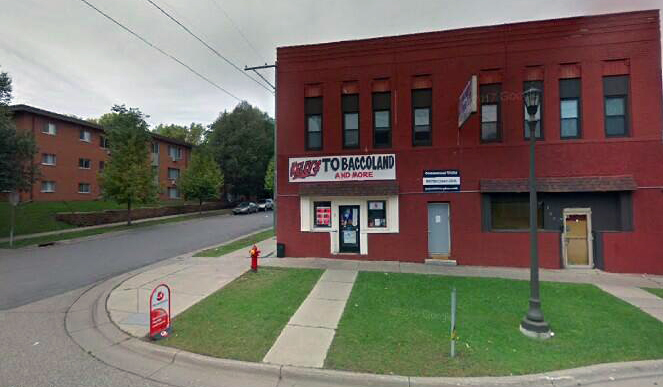
Brown Derby/Tobacco Shop – Google Image
The Buckhorn Cafe was located at some unspecified location on Highway 12 in Long Lake. Judging from the ad below from 1947, I thought for sure there must have been some music – some cowboy music? [This is not to be confused with the Buckhorn Tavern at 2701 E. 25th Street, or the Buckhorn Inn between Stillwater and Hudson, which sounds like it was a lot more fun.]
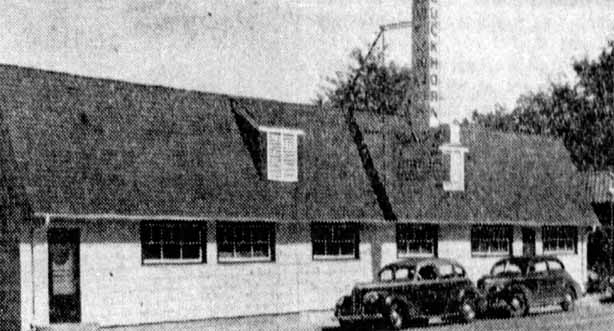
Minneapolis Star, September 6, 1941
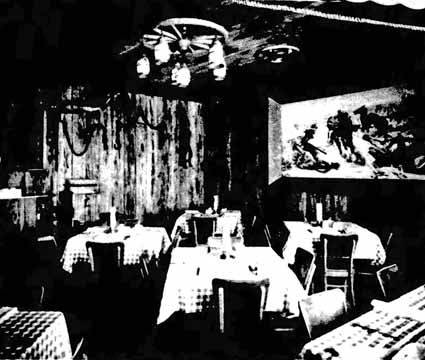
Longhorn Room, May 1, 1955
As it was located out of town, the Buckhorn was forced to close for the duration of World War II. Staff and customers were away at war or unable to get gas, tires, etc. for their cars. It reopened in November 1945.
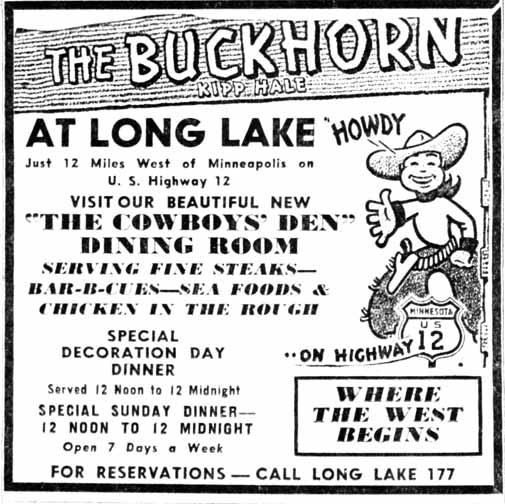
Minneapolis Star, May 23, 1947
So I looked and looked and looked but it turns out that it was “just” a restaurant and a four-lane bowling alley. From one source it computes that it was started in 1931 by Clifford “Kipp” Hale and silent partner Garnet Hale. Kipp had many collections, including animal heads, horns, mounted animals, and antique guns. And in this atmosphere is where you ate your “Chicken in the Rough,” an innovation that sounds like just fried chicken you eat with your hands.
BUFFALO HUNTS IN LONG LAKE
Kipp also collected buffaloes – real buffaloes – that had a habit of getting loose from their pens, in which case they were shot and eaten. Poor Hattie. In a 1952 column, George Grimm described this phenomenon:
Most folks know Long Lake because of three buffalo in back of Hap Hale’s Buckhorn Restaurant and recreation center. Two winters ago the buffalo decided to skip the fences and took off. People kept opening garage doors to find a buffalo inside. One train was raced by one of the critters (the train lost), and a national magazine took up Long Lake’s buffalo hunt story. The trio finally was corralled again.
Corralling the beasts was done by hired cowboys on horseback, with the entire town watching. It is unclear whether he brought in the buffaloes for publicity or for the meat, or both.
THE BUCKHORN CLUB
Kipp wanted to retire and advertised the place for sale in 1961. He kept his collections in the building, however.
On March 18, 1972, the Buckhorn Cafe burned to the ground, destroying his collection of 75 guns. The fire took the departments of Long Lake, Maple Plain, Wayzata, and Mound four hours to put out.
Within two weeks, the owner, Charles L. “Buck” Kramer, reopened the Buckhorn in a new location. The former tractor and farm implement shop at 2365 W. Wayzata Blvd. was ready in record time. Kramer changed the name to the Buckhorn Club, and installed a rock band (aha!), lingerie show, and topless dancers. By June 1974 the IRS was after him for underwithholding workers’ taxes, and in September 1975 he sold it to Gil and Patricia Carmichael.
The last we see of the Buckhorn Club is in 1977 when the City Council of Long Lake got tired of the nudity and the bad reputation it was giving the city, so it was considering cracking down on them.
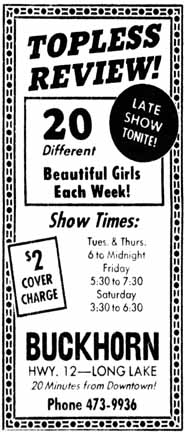
February 24, 1977
The Bull Pen was one of the best-remembered venues in Hopkins’ Opera Hall, located at 814-16 Mainstreet, Hopkins. The original address was Excelsior Ave., before the realignment of Excelsior Ave. when Highway 169 came through.
This page will cover the various entertainment venues that have come and gone in the building, including:
- The Opera Hall, aka Olson’s Hall
- (Sheehan’s) 908 Club
- The Bull Pen
- The Opera Hall Saloon
- The Mainstreet Bar and Grill
The building had two storefronts, East and West, and a large hall on the second floor that was rented out for events. The hall was used extensively by the community, as it was the largest in Hopkins.
OPERA HALL
There is some conflicting information about the origins of the building. The county’s tax database says that it was built in 1900, and there is plenty of evidence that it was once known as Olson’s Hall. This leads me to believe that it was built, or at least financed, by Hilmer Olson. [There was another, older, Olson’s Hall, located at 1209 Washington Ave. So. in Minneapolis, that went back to at least 1880.]
HILMER OLSON
Olson was a wealthy farmer, and for 22 years he was a banker at the First National Bank of Hopkins. He was born in about 1863, and in 1931 he lived at 904 1/2 Excelsior Ave. In August 1939 he and his wife were in a car/truck accident – he was driving the car. His wife, age 63, died as a result of her injuries. He remarried before his death in August 1946 at the age of 83.
OTHER NAMES
Nothing comes up under Olson Opera Hall; there were only a couple of hits under Hopkins Opera Hall. It was mostly called Olson’s Hall from 1900 to 1940.
ALBERT F. ANDERSON?
But an article in the Star and Tribune, apparently based on information from the Hopkins Historical Society, dates the building to 1904 or 1904, and says it was built by Albert F. Anderson. A search through the Strib archives reveals that Anderson applied for a liquor license for both storefronts in the building on block 4, lot 1, for the period between April 1, 1898, and March 31, 1899. He made the same request for the time period from April 1, 1899 to March 31, 1900, but this time only for the West Room. He is mentioned in 1905 when a bartender accused Anderson of giving him a beating for being late in opening his saloon.
Problems include the fact that the Hall sits on Block 4, Lot 3 – Lot 1 is on the western corner of the block. That building is listed as being built in 1902 in the County’s database. Perhaps more research is needed in the Hopkins papers.
ACTIVITIES IN THE HALL
The Opera Hall was used for dances and recitals, sponsored by different groups. The first activity we see in the Strib archives at the Olson Opera Hall is in September 1902, which is a political meeting.
THE ODD FELLOWS PARTY
Shortly after that, in 1903, was a rip-roaring Odd Fellows Carnival – actually the overflow from the new IOOF Temple that was across the street. The carnival went on for days, with each day sponsored by a different Lodge of Odd Fellows from Minneapolis. On September 29, 1903, for example, the North Star lodge descended on Hopkins, “accompanied by Coon’s orchestra.” Members entertained the crowd with routines “in the arts of black-face minstrelsy.” One man’s monologue on milk sent the audience into “paroxysms of laughter.” Coon songs, routines in black face, and minstrel shows were still much in vogue in 1903. The Odd Fellows from Minneapolis might have actually seen a black person; although the City was very segregated, the few black men and women living in town could generally find employment as Pullman porters, hotels workers, and other low-level jobs. Whether people living in Hopkins had ever seen black people is something to wonder.
The following night was sponsored by the Flour City Lodge, with decidedly more sedate entertainment featuring a Masonic quartet, violinists, a “facial and musical artist,” and a humorist and impersonator who “will make fun.” Despite these hilarious hijinks, there was no rowdyism, and “no trouble, no fakirs, no grafters,” reported the Deputy Marshall.
Thursday was Ladies’ Night, presented by 25 of the ladies of the Iola Rebekah Lodge No. 35, who tended to be “more or less literary and musical, with vocal and instrumental solos, recitations, tableaux, etc.” Sounds like those ladies in the “Music Man:” “Ode to a Grecian Urn.”
And this:
One of the most unique exhibits seen at the carnival is a monster cigar manufactured by J.Y. Kern of Hopkins. The immense “smoke” is eight feet in length, eight inches in diameter and weighs twenty-five pounds. It is named “The Dr. Moore Cigar,” in honor of a local physician.
May 1906: Sorenson and Wallace Bakery (Hopkins News, per HHS)
In 1909, wrestling was a draw, continuing until at least 1912. (Strib)
In 1911 the building was sold to Charles Shonka, who ran a beer parlor, then liquor bar. (816)
1915 – 1933: The upstairs was the home of the Sokol Society, a gymnastics group made of people of Czech heritage. (HHS)
1920 – 1937: Shonka’s Cafe (816)
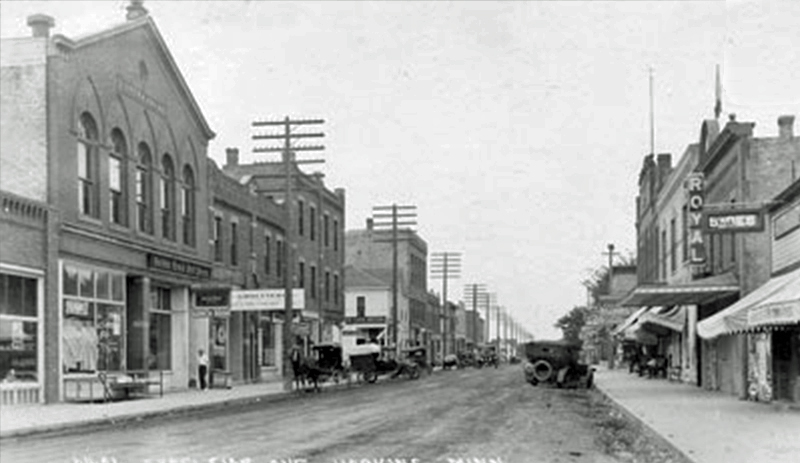
Hopkins Opera Hall on the far left – image from Hopkins Historical Society
STAG PARTY RAID!
On May 1, 1932, nearly 500 men, allegedly identified as the Minnesota Chauffeurs’ Club from Minneapolis, attended a stag party at Olson’s Hall, paying $1 each to enjoy five girl dancers doing “a series of butterfly dances, difficult to describe in mere words.” Unfortunately, a dozen deputies rose in their seats and announced the place was raided. Someone turned out the lights and there was a mad dash for the door; two of the deputies were injured in the melee. The girls were jailed, plead guilty, and were ordered to pay $50 or spend 60 days in the county jail on charges of indecent exposure. Four men were charged as alleged producers and drew similar sentences. (Minneapolis Star, May 5, 1932)
At trial, the questions and answers were a bit difficult to answer:
“What were the girls wearing?” Justice Meeker asked Deputy Oscar Thompson.
“Well,” gulped Thompson, “they seemed to have on shoes and stockings.
“What else?”
“Something gossamer that shed in layers.”
“Was it artistic?”
“I’ll tell the world it was.”
October 1937: Hopkins Variety Store (814)
September 1947 – 1961: Hopkins Alleys (816)
April 1951: C.J. Sommers Variety Store (814)
May 1955: Swanels Surprise Shop (814)
SHEEHAN’S 908 COCKTAIL LOUNGE
November 1955: Sheehan’s Bar (816)
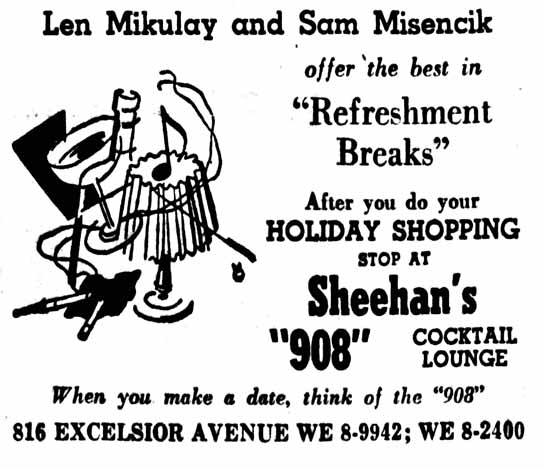
Minneapolis Star, November 15, 1956
In November 1958 there was a fire at Sheehan’s bar. The owners were identified as James, Thomas, and John Sheehan. The building held a bar, liquor store, and bowling alley, which had been there since at least 1947.
On December 14, 1959, a dram shop lawsuit identified the owner of Sheehan’s as Lee G. Zrust.
After these troubles, Sheehan’s apparently became just The 908 Bar, described as a workingman’s bar with no entertainment.
THE BULL PEN
In about February 1959, the Bull Pen took up residence in the 814 side of the building. It was opened by Harry Blons as a venue for his jazz band.
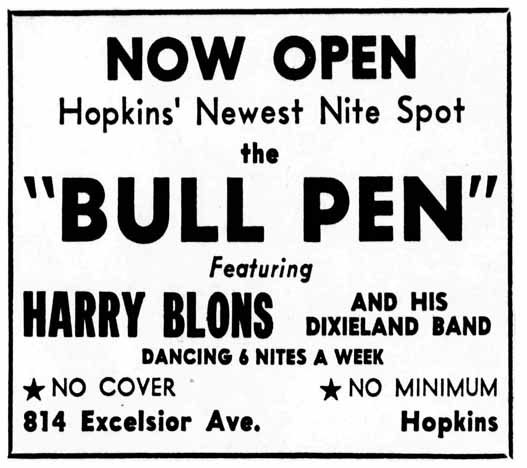
Minneapolis Star, February 26, 1959
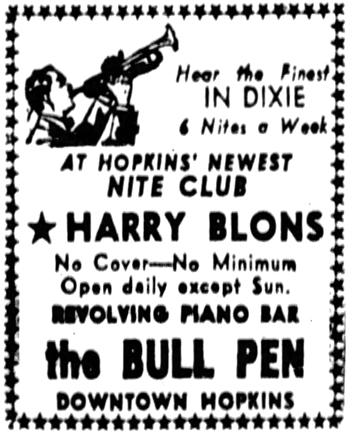
July 4, 1959
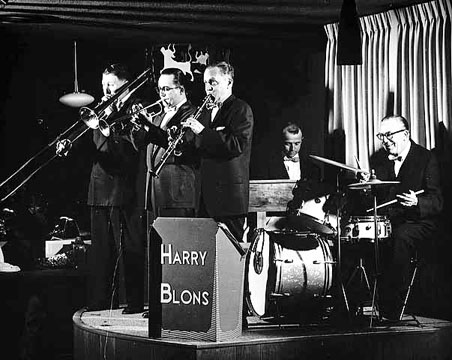
Undated photo of Harry Blons at the Bull Pen from Minnesota Historical Society
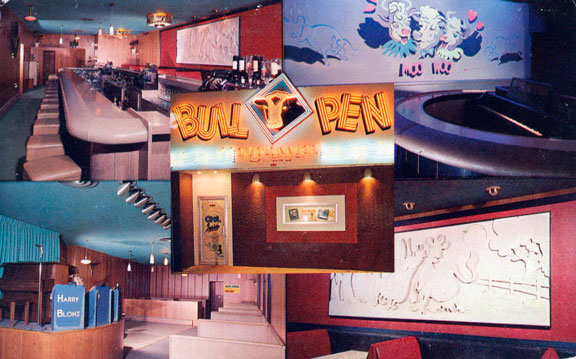
The Bull Pen hosted other types of music as well, including jazz and country.
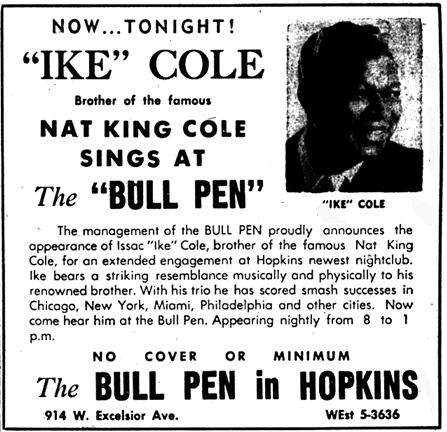
September 1, 1960
In 1961 the building was purchased by Virgil Miller, Dick Strachota, and Don Nickodym.
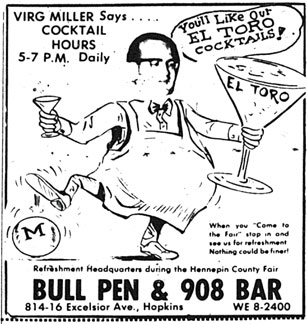
August 1962
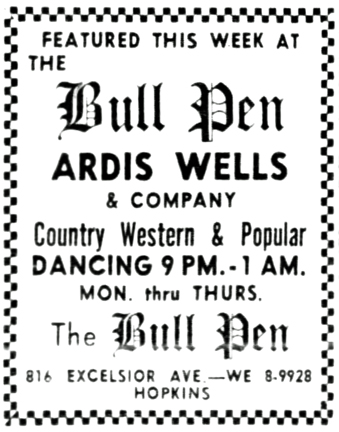
January 19, 1963
1963-64: Big Daddy and the Misfits played there for at least a year.
BULL PEN A GO-GO
In 1967, the Bull Pen took a turn toward loud music and G0-G0 dancing, even though the Go-Go fad was kind of a 1965 phenomenon. But the Bull Pen took it further, providing 15 years of nude dancing – the only bar in town to do so.
It appeared to start innocently enough. In one of his typically hilarious columns, Jim Klobuchar focused mostly on the noise generated at the bar, going so far as to bring a decibel meter to compare the cacophony to other known noise nuisances. He was blown away:
You may have heard noise in your life but you have never been so completely blasted, stretched, and flattened until you have spent a couple of hours in the Bull Pen Bar on a Friday night.
That was just the band. The Go-Go dancer was a “spectacular blonde named Cheri Rexroth, thrashing a go-go on a tiny platform.” Cheri was born in the Twin Cities, learned her craft in Chicago, returned with her “acrobatic culture. Tonight she is wearing tangerine tights and frequent expressions of anguish.”
Virg Miller explained that “We could advertise more, but we’d bring in the riffraff. We like to have them come reasonably well dressed and so we try to keep out the hairy-chested, open-shirt characters…”
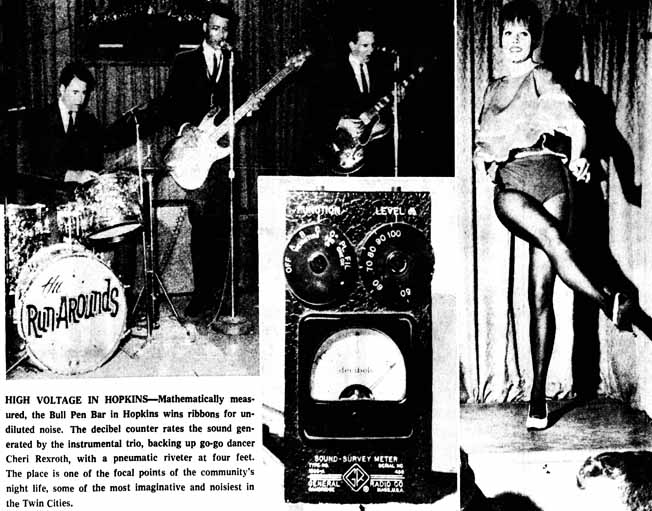
Minneapolis Star, June 19, 1967
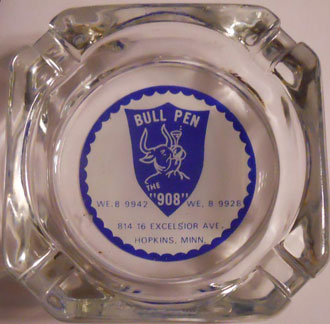
From the collection of Mark Youngblood
A 1968 ad from the Minnetonka Sun said the Bull Pen was owned by Virgil Miller, the band was the Professionals, and “Sheri” provided the “very best in GO GO.”
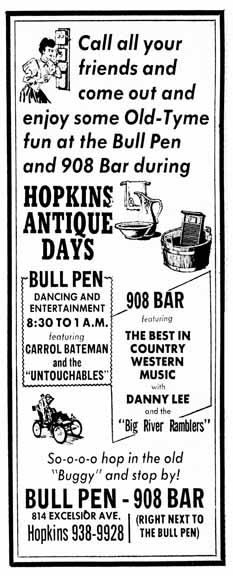
Minneapolis Star, April 4, 1968
Eventually the go-go dancing drifted to nude dancing, and stayed that way until 1982.
OPERA HALL SALOON
The Bull Pen had to go. After 15 years of nude dancing, in 1981 Hopkins enacted an ordinance that outlawed such activity in bars. The ordinance was based on a St. Paul ordinance – Hopkins just scratched out the name St. Paul and substituted Hopkins. The Chief of Police couldn’t see the dancing go fast enough, noting that most of the customers were men, most were not from Hopkins, and they were more rowdy and boisterous” than those at other bars. In February 1980, a customer shot a bouncer through the neck.
In February 1982, the owners closed the bar and began a renovation that would cost them about$258,000. $78,000 of that amount came from a low-interest loan provided by the City to fix up Mainstreet buildings.
Work included removing coverings from floors, ceilings and walls, exposing the old tin ceilings and brick walls. Arches were cut into the brick inner wall, connecting the Bull Pen and the 908 Bar. The 908 Bar stayed open for all but one month of the six-month construction period. The dance floor and bandstand were on the Bull Pen side.
The Grand Opening of what was called the Opera Hall Saloon was August 10 through 15, 1982. The music changed to Country, Country Rock, and ’50s.
MAINSTREET BAR AND GRILL
This new business first advertised for staff in October 1988. It is still there!
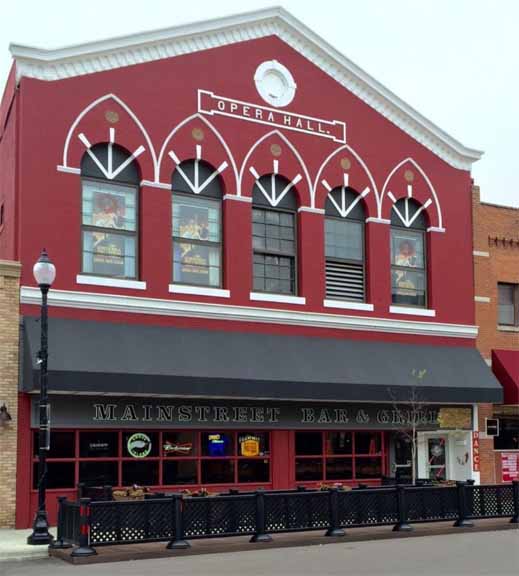
The Bungalow Bar was located at 6221 – 56th Ave. No. in Crystal.
It goes back to at least September 1951.
From 1967 to 1969 they featured a nightly organist and a weekend piano lounge.
The Burnsville Bowl was at 1200 E. Highway 13 in Burnsville – the northeast corner of Highway 13 and Minnegasco Road, as it was described when it was built in 1967. It was developed by the owners of the Maplewood Bowl. Original plans called for 24 lanes, a bar, restaurant, and a nursery.
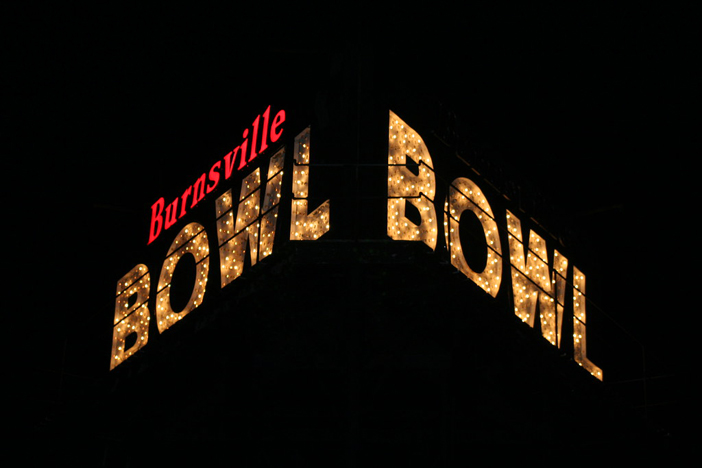
Photo courtesy Burnsville Historical Society
El Matador Lounge: April 1967 to September 1970
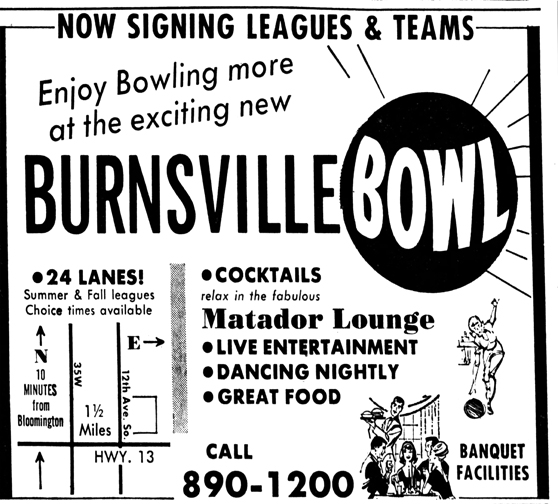
March 26, 1968

January 24, 1969
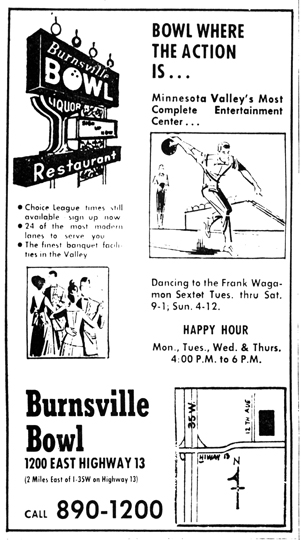
August 10, 1969
1970: vocal group upstairs and “acid rock” downstairs.
In 1972 the El Matador Lounge was managed by Milton Olsen.
In December 1972 there was a room called J.T.’s, but that didn’t seem to last long.
EL TIGRE LOUNGE
In April 1973 the El Tigre Lounge featured Bea Bea Benson, “Miss Showmanship;” pianist, songstress, and risque comedienne.
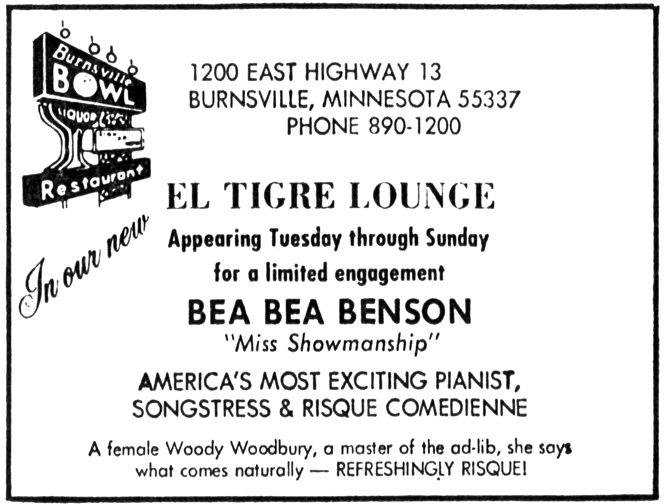
April 29, 1973
OBSCENITY IN BURNSVILLE
In May 1974, Mayor Alfred Hall, a Mormon bishop, sought to get rid of the go-go dancers and lingerie shows at the cocktail lounge, calling it a “tide of filth.” Under the threat of losing its liquor license, owner Milton Olsen voluntarily discontinued the shows. The issue spread to an all-out obscenity campaign by the Mayor, who proceeded to draft the filthiest ordinance imaginable. The City Council passed the ordinance, and Olsen said he would lose $100,000 in business as a result.
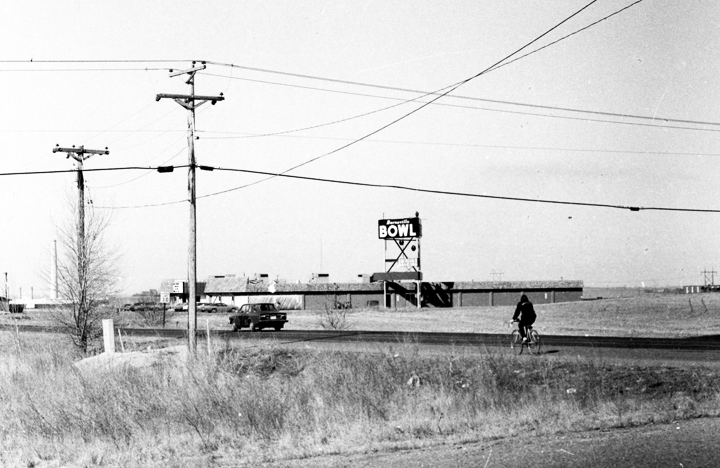
Burnsville Bowl 1977. Photo courtesy Burnsville Historical Society
An article in the Minneapolis Star called the Bowl a “cowboy-biker-bowler bar complex” with a “blue collar mellow” ambiance. It had a “crazy mix of ‘Saturday Night Fever’ heavily tempered with ‘Urban Cowboy.'” The article described the five “play areas” at the Bowl. (August 22, 1980)
THE PLAYPEN
The Playpen was the only area that had a cover charge, which was usually $1.50, more for special events. In 1979 the Playpen hosted Minneapolis’s answer to Elvis. Country rock was the music of the day in 1980, and the dance floor was described as tiny.
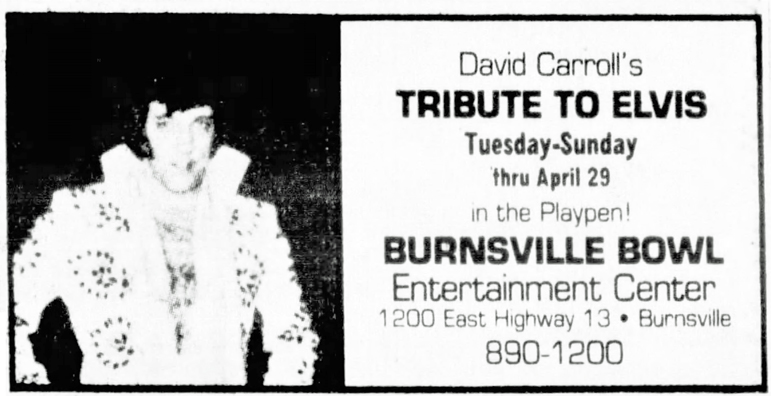
April 15, 1979
FANNY HILL’S
This was a quiet lounge with “live mood music” and snacks. It was “decorated in in red felt walls and black velveteen couches in old-time bawdyhouse style.”
THE SPARE ROOM
Spare, bowling, get it? This was a “quiet bowlers’ bar with a TV, adjoining the 24-lane bowling alley and a hall stuffed with shuffleboard courts and pool tables.”
THE SNOOPY ROOM
Also known as the Nursery, this was still being used as a nursery during the day. By night it was a “quiet one-table pool room for those who value concentration.”
SILVER SLIVER
In 1977 the Silver Sliver was a disco in the basement. Here is a review by the Minneapolis Tribune (November 4, 1977):
Getting there is half the fun, since the only way to enter is down the Silver Sliver, a circular slide that makes 1 1/2 revolutions on your way down. (You have to use the more-mundane stairs to get out.) Dancers select their own records on a juke box. Small dance floor.
In 1980 the article said it was a place “where young men in vests and cowboy hats with folding Buck knives strapped to their belts boogie on the small stainless-steel dance floor.”
Another article described the clientele as “the most un-disco-looking dancers you’ve ever seen grinding around on a small steel floor.” Also, “The mellowness is enforced by leather-vested heavies.” (Star, October 17, 1980)
In December 1983 the owner was Deleano Benjamin.
In August 1992, Jungle Bungee set up a crane in the parking lot and participated in the bungee jumping fad. The first jump was $55, the second $25.
HOT SHOTS BAR
The Hot Shots Bar was around in April 1995
In 2007 you had the 12th Avenue Lounge and the 1200 Club.
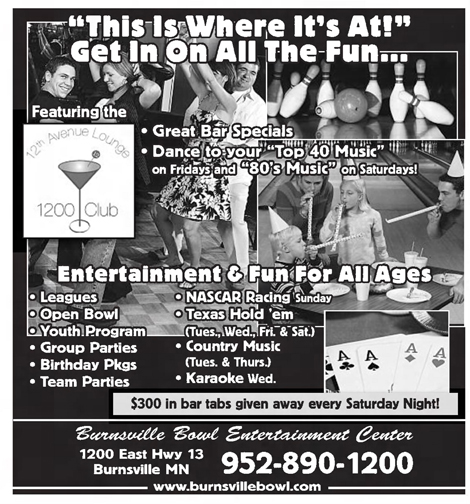
March 7, 2007
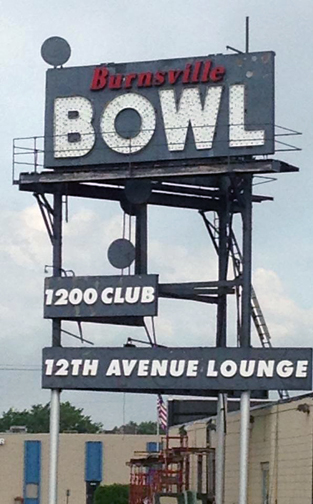
Photo courtesy Burnsville Historical Society
The Burnsville Bowl building was sold and shuttered in 2010.
17 – 8th Ave. So., Hopkins. 1969: Dancing to the Sociables. 1970: Live music and entertainment (and art) in the Gallery Room; vocalize and fraternize in the tuneful Blue Note piano lounge. Still there in 1974. A 2001 article says that it “had given way to McThirsty’s.”
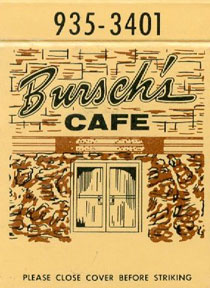
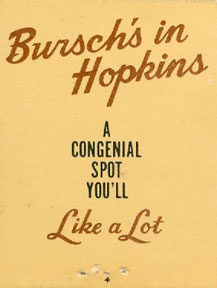
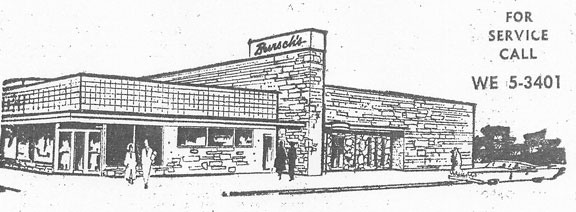
From 1960 ad in St. Louis Park Dispatch
111 So. 6th Street in Minneapolis, was described as a popular place for “young swingers” in 1965.
383 Michigan Street, St. Paul: The historic Česko-Slovanský Podporující Spolek (C.S.P.S.) Hall has been the home of Czech and Slovak Sokol Minnesota (Sokol MN) since 1879, and the focal point for its activities in St. Paul since the current building was built in 1887. It was declared a National and State Historic Site in 1977, placed on the National Register of Historic Sites, and is the longest serving Czech-Slovak cultural center in the United States, and oldest theater and national hall in the State of Minnesota. The building is still active and available for rental!
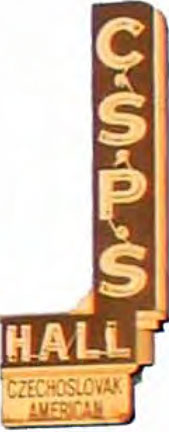
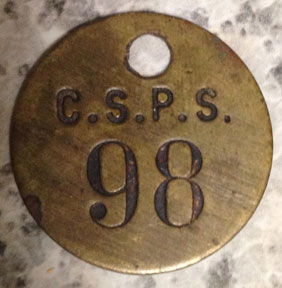
Coat check token
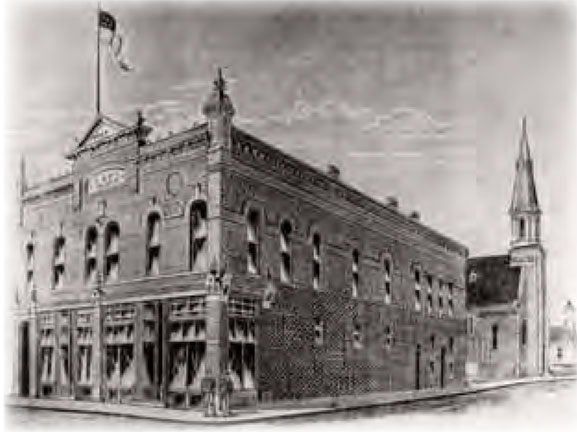
This venue was located at 770 E. Seventh Street (at Eichenwald) in St. Paul.
In April 1906 the Dayton’s Bluff Commercial Club moved into what had been the Mayhall residence. It was described as “an imposing brick and stone mansion.” (Minneapolis Journal, April 5, 1906)
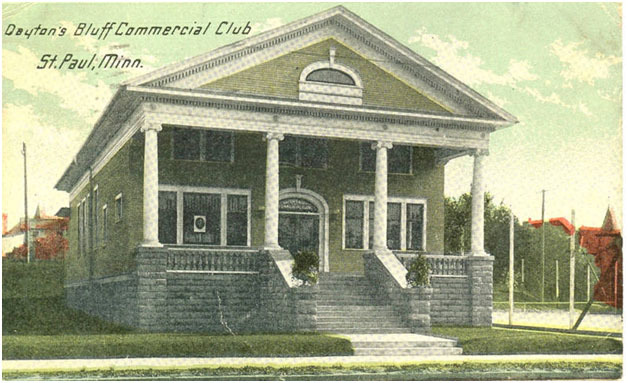
Postcard dated 1913, courtesy Minnesota Historical Society via St. Paul Historical
According to an article by Steve Trimble at St. Paul Historical, over the years the Commercial Club expanded the building to include a bowling alley, private dining rooms, a men’s smoking room, a billiard area, and a banquet hall and dance floor.
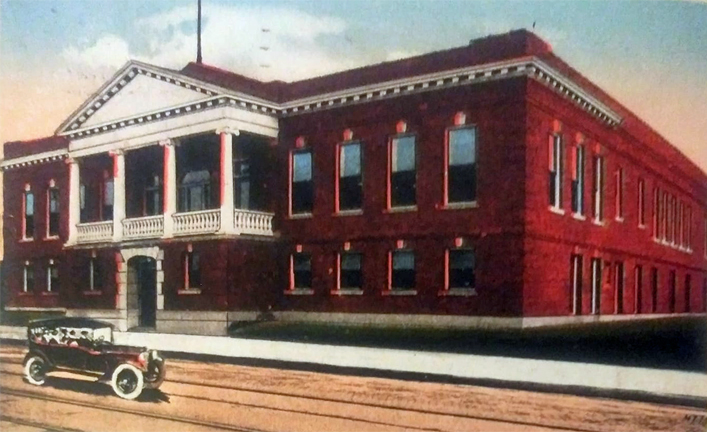
Dayton’s Bluff Commercial Club – Image Courtesy John Kass
References to the club in the Minneapolis papers lasted into the 1950s.
THE CABARET
Bob Mecay opened this venue in the spring of 1968: “Newest and Largest Sports and Entertainment Spot in the Midwest.”
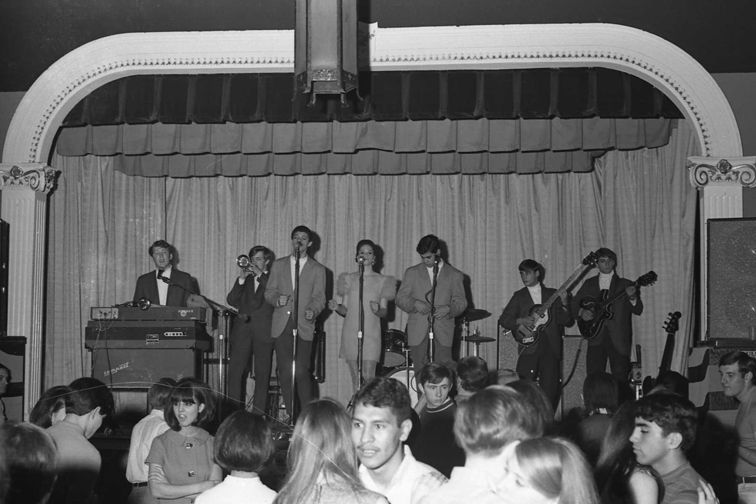
The Perspectives at the Cabaret, April 5, 1968. Photo copyright Mike Barich, St. Paul
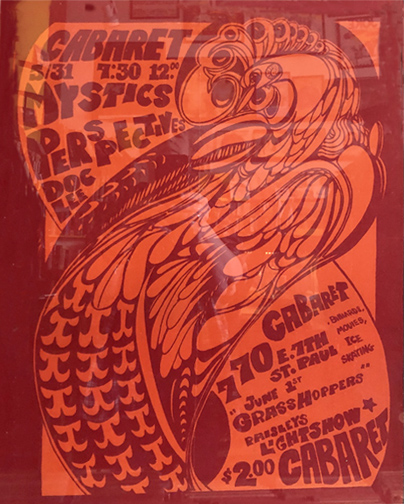
Poster from the collection of Mark Freiseis
On discount night, Musicians got 50 cents off the admission price.
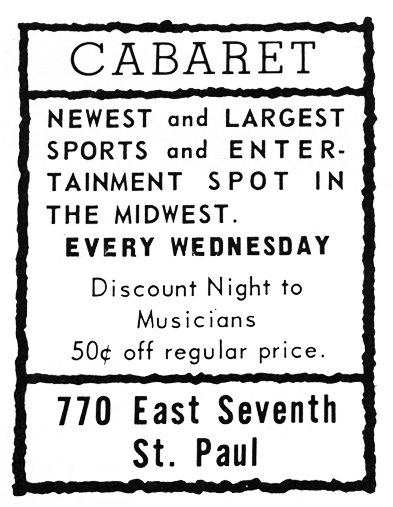
Ad from the Insider, August 3-10, 1968
It was ages 18+ on Fridays in January 1969 and offered ice skating on an indoor ice rink.
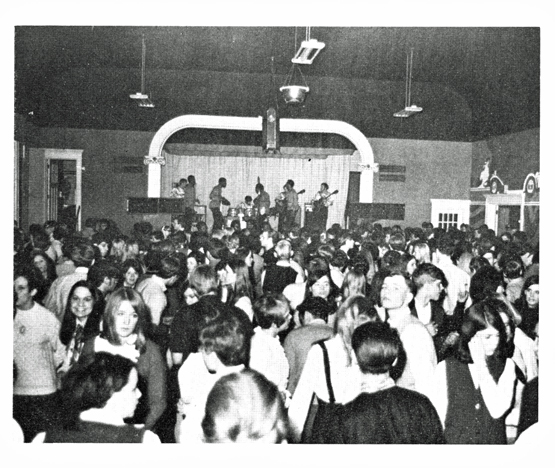
Showtime at the Cabaret. Photo by John Gilbreath, Insider, January 1969.
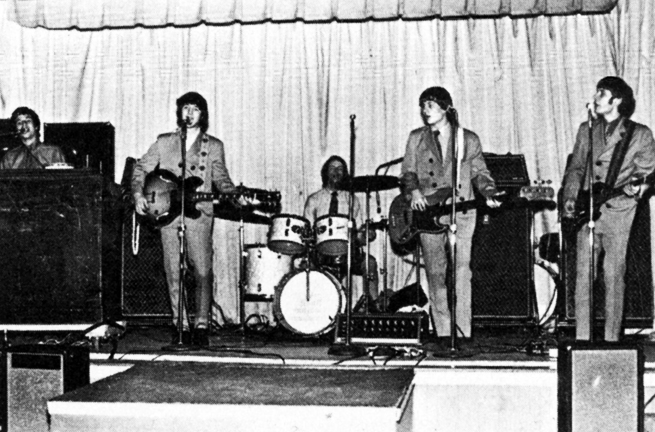
The Bananas at the Cabaret. Photo by Mike Barich, Insider, April 1969.
THE BANK
Bob Mecay changed the name of the Cabaret to The Bank in 1969.
WORM CITY U.S.A.
In a surprising turn of events (see what I did there?), in February 1978, the building (or at least part of it) became the site of Worm City U.S.A., a worm farm owned by Bob Amos of St. Paul. Apparently a couple of get-rich-quick worm dealers had hit town, promising people that they could start worm farms with a modest investment and make lots of money selling their worms for bait and such. The state was shutting the shysters down, but not before one of them, “Wormworld,” sold a package deal to Mr. Amos in the fall of 1977. Amos had started growing his worms in the basements of a couple of homes before he moved his operation into “an old lodge hall.” By April 1978 he had 220 wooden crates containing about 4 million worms.
The Minneapolis Star reported that “Amos has yet to sell a worm, but he said he has been concentrating on building up his stock. Amos said he will package 1,000 worms in each bag and he will advertise on radio to try to sell them to home gardeners.” (April 13, 1978)
THE BUILDING TODAY
As of 2020, the building is the home of the Ethiopian Evangelical Church. John Kass notes that much of the exterior entrance and overhang was removed to accommodate widening of 7th Street.
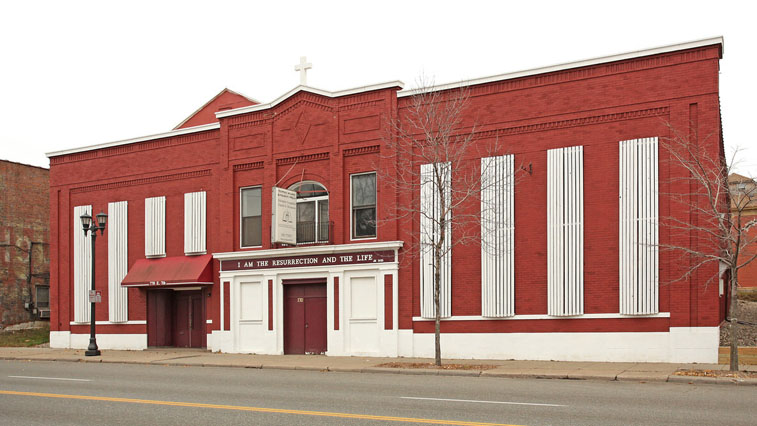
The Cabooze is located at 917 Cedar Ave. on the West Bank.
John Hanson talks about the mural he painted for the Joint and the Cabooze:
On this day, 42 years ago – August 10th, 1974, I completed my first job for the soon-to-be open Cabooze Bar…their inaugural week…in July while sitting in The Joint Beer Garden, I was enjoying a frosty Grain Belt Premium with my friend Dennis Brown…I remarked to Charlie “Woodchuck” Campbell (Booking Manager for the new club) that the bare walls begged for “something”…”come up with something” he said…so I did…resulting in this…assisted in painting by Brian Ringham (shown here painting my shirt)…the opening act that week was a rag-tag traveling troupe of marauding Vaudevillians and hooligan Hippies known as “The Friends Roadshow”…some 2-dozen rather mad artists who regaled us with a blend of mirth, magic & mayhem…”a little song, a little dance, a little seltzer down the pants!”…beginning then, what has gone on to become a true Twin Cities legend (and The World!), Lo, these many years…with no end in sight…thus began also, the jumpstart I needed for my brand-new one-man-shop graphic design biz: “Mill City Miracle Graphics”…(If it’s A Good Graphic, It’s A MIRACLE!)…having done hundreds of pieces for both The Cabooze & The Joint over the decades, I have nothing but gratitude for Jimmy Brown, Charlie Campbell, Rollie Olson, Taco and all the Staffers and friends there that have allowed me to shine and enjoy perhaps my most Leviticously Deuteronomous good times on Planet Earth…thanks, kids… but sadly, one day this was painted over …replaced by someone with characters from the comic strip “Peanuts”…Charlie Brown, Lucy, Linus, Snoopy…alas now, lost to the pages of History…except here…”mighty oaks from little acorns grow”…
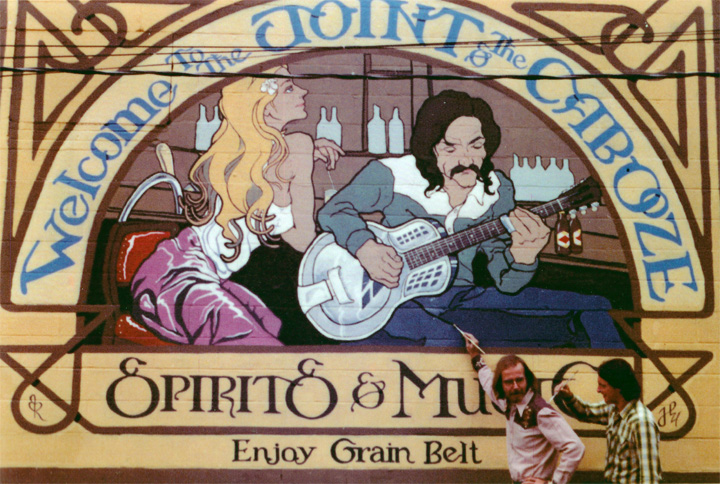
Cabooze & Joint Mural by John Hanson, August 10, 1974
Save
320-322 Cedar Ave. So. is an apartment building (or series of buildings) built in 1901. It was the home of music venues including:
- Stephano’s
- The (New) Holland Cafe
- Caesar’s
- The Unicorn
STEFANO’S
An August 1959 rundown of dining venues published by Will Jones in the Minneapolis Sunday Tribune describes Stefano’s as the “original home of Minneapolis’ would-beatniks. Assorted jazz Friday and Saturday nights. Art exhibits. pizza, sspaghetti. Open 5 pm to 3 am. The address given is 316 Cedar Ave.
THE NEW HOLLAND CAFE
The Holland Cafe goes back to at least May 1926. In April 1936 the liquor license was owned by Morris Track.
In the wantads under “Let’s See the Town” are items for Frehe’s New Holland Cafe, starting in April 1950. A Grand Opening was noted on May 8, 1950.
An item dated January 1957 names Richard Ersbo as the holder of a liquor license here.
And in December 1957 an ad says that the Holland was open again. It was still the Holland in February 1962.
The next owner, Dave Lee, was quoted by Will Jones as saying “It was a skid-row place and a homosexual hangout. I had to do something drastic to change the image or lose a lot of money.” Jones said that Lee “discouraged the rowdyism and the eyescratching of the old clientele.” I don’t know what that means either.
Is this the same New Holland Bar that, in 1963, featured Caribbean and Latin music, with Bill “Boss” Gordon and his LaBombas. “Come see and learn the new dance craze – Limbo”
CAESAR’S
THE UNICORN
On October 2, 1965, the Lees turned back room of Caesar’s into the Unicorn. It had a separate address of 321 – 16th Ave. So. It was decorated as an English pub, with beamed ceilings, dart boards, a reading rack, and a separate bar. Plans were also to serve fish and chips and sandwiches. (Will Jones, July 18, 1965)
602 Lyndale Ave. No. Advertised as “Something Different” in September 1938, with “Chinese Foods and Good Entertainment.” Also see Club Delissa.
1329 So. Fourth Street, Minneapolis. Opened September 17, 1939, owned by Tommy and Harry Lewis. Opening night entertainment by Rook Ganz and His Entertainers. Chicken and Chinese Dishes their specialty – Come out and have a grand time.
The Cafe Expresso, at 2605 Hennepin Ave., was included as a coffeehouse/music venue in a 1967 newspaper list.
Please see Mr. Lucky’s.
The Calhoun Ballroom was at Lyndale and Lake in 1944 – probably the same location as one or more entries here. The Red Pepper Orchestra provided a smooth dancing program that December.
Calhoun Beach Hotel, Minneapolis. Site of many University of Minnesota Greek dances.
The Camden Bank was located at 42nd Ave. No. and Lyndale Ave. No. in Minneapolis.
The Camden Bank building was built in two sections:
1910 BUILDING
In 1910 the Odd Fellows Highland Lodge No. 99 purchased the block and built a two-story building facing 42nd Ave. No. as their IOOF Lodge. The address of this building 707 – 709 42nd Ave. No.
The building was designed by Septimus J. Bowler and constructed for $9,000 by Charles E. Hagstrom. In the beginning, the first floor of this building was used as an “undertaker’s parlor” and post office. The second floor was ballroom with an octagonal dome in the ceiling.
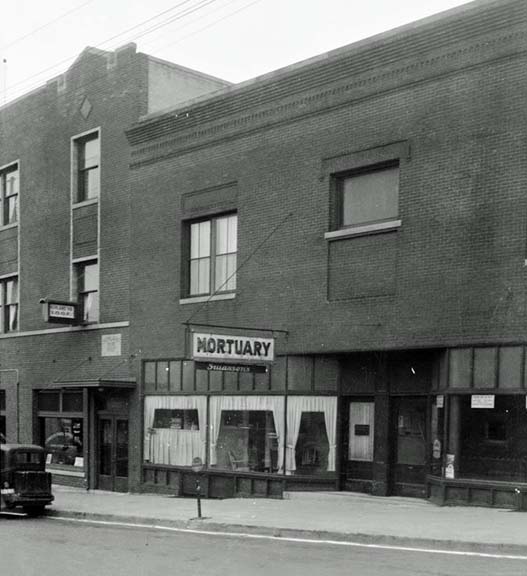
1936 photo courtesy Minnesota Historical Society
1920 BUILDING
In 1920 the IOOF Lodge built a $40,000 three-story addition to the first building, facing Lyndale. The building replaced three frame stores that had been built in the 1890s.
The architect was Ernest C. Haley, and the builder was Charles J. Johnston. The original address of this building was 4169 – 4171 Lyndale Ave. No. The permit card described this as “bank and lodge hall.” The basement was originally used as a pool room and bar. The original plans call for the third floor to be used partly as a banquet hall with kitchen.
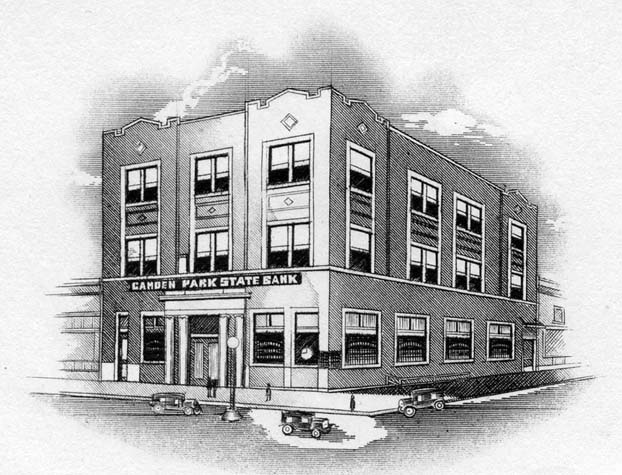
Artist’s conception, presumably by E.C. Haley. Courtesy Richard Sigurdson
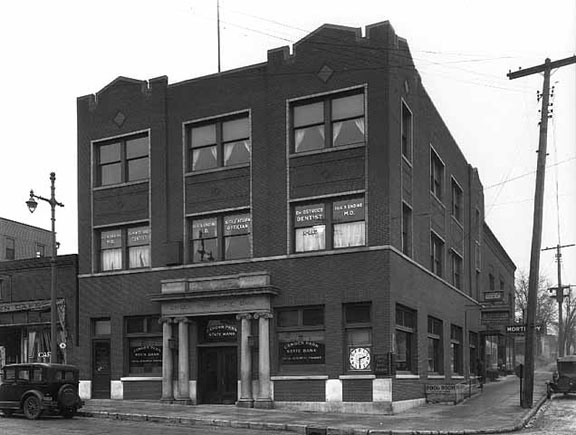
1928 photo courtesy Minnesota Historical Society
For years the two sections had two addresses, as listed above. They are, and always have been one building, in actuality, and have always had one owner. It now carries the address 705 42nd Ave. No.
THE BANK
My friend Richard Sigurdson provided some history of the bank and his grandfather:
The Camden Bank was organized on October 3, 1910, and was originally located on Washington Ave. In 1920 it moved to the new building on Lyndale and 42nd Street.
In 1910, Goodman G. Sigurdson, a native of Iceland, moved to Minneapolis in October 1910, and helped organize the Camden Park State Bank. He was the first head cashier when the bank opened. He served as president from 1922 until 1953, when he was appointed Chairman of the Board, position he held until his retirement in December, 1956. In 1955 the bank moved to 4141 North Lyndale. It was sold to Norwest Bancorp, which is now Wells Fargo.
DANCES
The second floor of the 1910 building on 42nd Ave. No. was a ballroom, and in 1959 North High student Marsh Edelstein started to organize dances on Friday and Saturday nights. He wanted a place that was available to kids from North and Edison Highs, and its popularity spread to kids from other high schools to become one of the biggest Minneapolis hangouts.
Local bands were booked for the dances: the DelCounts, the Underbeats, the Accents, the Trashmen, Castaways, Avanties, etc. Rod Eaton of the Underbeats shares the flyer below and his memories of the venue:
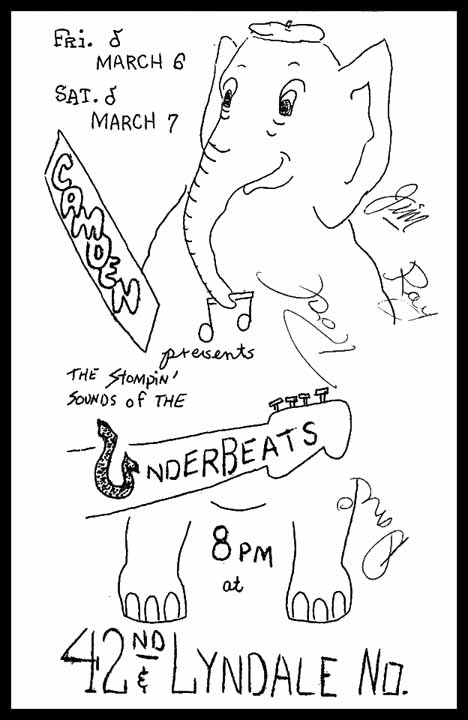
Courtesy Rod Eaton
Rod:
Here’s a flyer for a dance at Camden. It’s just five by eight inches but it tells a big story. Sitting on the corner of 42nd and Lyndale Avenue North is a brick building. It’s a restaurant now I think. But the second floor was an open rental space – people held wedding receptions and parties there. When the teen dance craze hit in the early ’60s, a couple of enterprising young men saw the space as college tuition. They promoted dances there every Friday and Saturday. It was always just called Camden.
Bands should have been paid more to play there – the only access was up a long flight of stairs. It wasn’t a lot of fun getting all our amps and drums up those steps. I pitied any band with a Hammond B3.
But once you muscled the gear up Camden became a truly jumping place. For starters it drew big throngs of kids. Then there was the floor – it literally bounced up and down when kids danced. You could feel it. I played in continual fear that we’d find ourselves suddenly on the first floor. That fear turned to panic when we played “Foot Stompin.’” Dancers would jump on the floor to every beat of the drums – boom, boom, BOOM, BOOM! Dust billowed up, the walls shook, the floor trembled. They loved it – we generally had to play the song twice a night. This flyer exploits that: “Presenting the Stompin’ sounds of the Underbeats.”
In a way Camden was home to the Underbeats. That was our side of the city and we had a lot of friends in the neighborhood – it’s where we got our start. Camden may have been the reason we made “Foot Stompin’” our first record.
Some kids remember fights there, but Marsh says he had good security there. He moved his operation to the Marigold Ballroom in 1962 because the Bank was not big enough and he wanted to bring in national acts like Chuck Berry, Bo Diddley, Little Anthony, etc.
In 1969 the building hosted a 181-seat theater to present live dramatic plays.
Throughout its life the Camden Bank building has housed a post office, pool hall, and professional offices. It is one of the only remaining buildings in the neighborhood, due to the construction of I-94, which the 1920 section faces, across Lyndale Ave. It is a welcome reminder of Old Camden, with its “I.O.O.F. No. 99” still engraved above the entrance of the 1910 section, and “Camden Park State Bank” still engraved above thee central main entry of the 1920 section.
520 Hennepin Ave. Illegal after-hours club, 1934-36, where jazz musicians would sit in after hours.
5300 W. 78th Street. This really was a medeval castle surrounded by a moat. Norwegian Hans Skalle opened Camelot in 1964, bringing French cuisine to the Twin Cities. Camelot was awarded the Holiday Magazine Certificate for Dining Distinction 1966, in less than a year of operation and again in each ensuing year. Continental cuisine, luncheons and dinner daily (closed Sundays/Holidays), buffet luncheons week days. Venues included:
- The Ale House
- The Jester Lounge (in the tower). 1967: Harmonica High Hats; 1970: good local and name entertainment
- Backdoor. 1973: The Fabulous Camelot Singers
- Great Hall. 1970: dancing on Saturday nights.
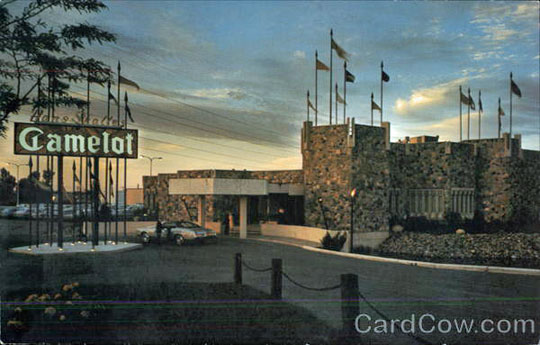
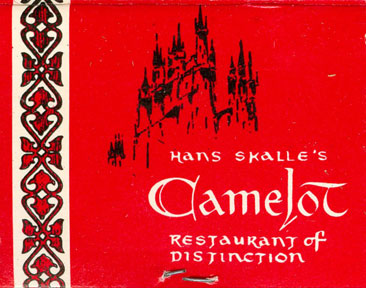
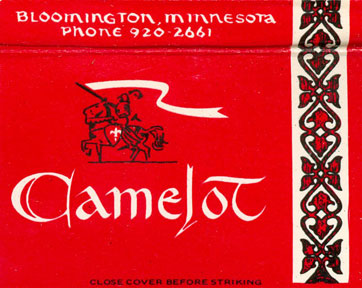
The Canterbury Inne and Pub was at 6481 University Ave. NE in Fridley.
Claims to be the first English decor pub in the country to offer authentic English pub music. In 1966, Maury Bernstein was providing the tunes while accompanying himself on an authentic pub-type squeeze box. (Minneapolis Tribune December 18, 1966).
The Inne was there until at least 1974.
There was a Capitol Tavern in St. Paul in 1949 that had music, but I have no location. Unfortunately I didn’t note the source of this factoid, but it probably came from Joined at the Hip.
Now we have a postcard of the Capitol Bar, located at Rice Street and University Ave., and I will post it here and guess that they may be one and the same. But no guarantees. St. Paul is the State Capitol, you know.
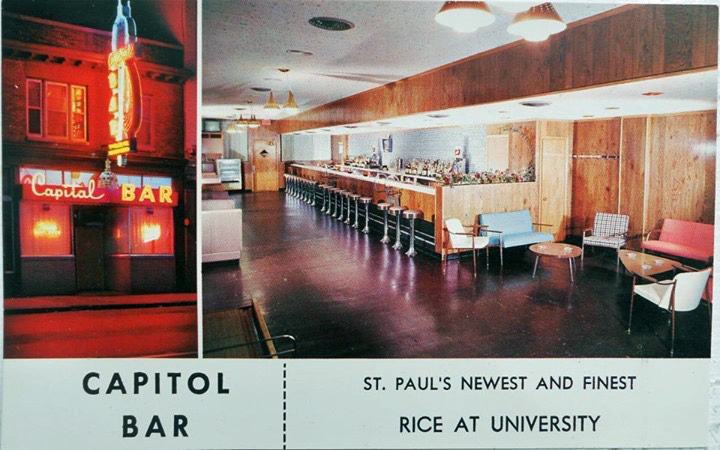
The Capp Towers Motor Hotel was located at 1313 Nicollet Ave. in Minneapolis. This hotel cost $6.5 million, had 350 units, and opened in March 1963.
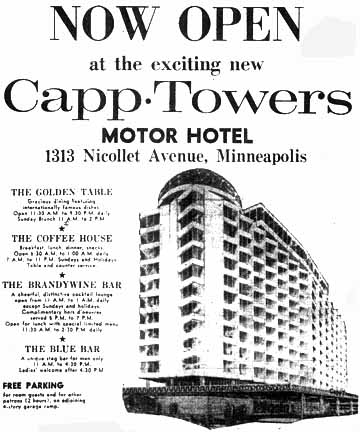
March 14, 1963
The Minneapolis Capp Towers had several music venues:
DOME AT THE TOP OF THE CAPP
Opened on March 1, 1963, this was a jazz and blues venue. Will Jones described the plan to have a low circular bar at the center, with the bartenders working in a kind of pit in order to give everybody a clear shot at the view in all directions. “A small musical combo will work in the center of the bar, and they will make their entrances and exits on a moving stage that will rise from and descend to the floor below for loading and unloading.”
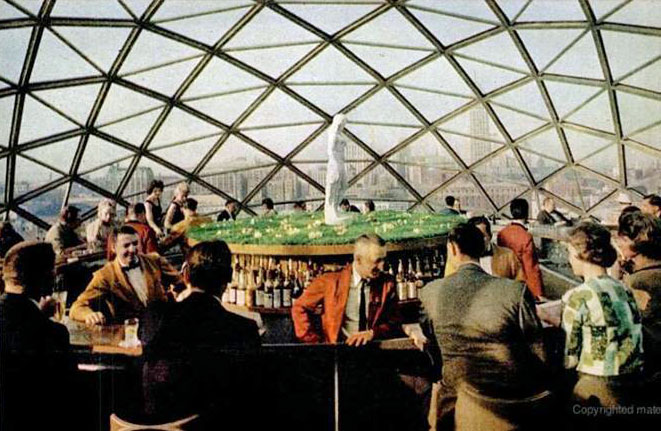
The photo above appeared in Life Magazine on July 26, 1963 with the caption: “In the domed cocktail lounge on top of 15-story Capp Towers, motel guests can enjoy a view of Minneapolis skyline. A revolving stage in the center of the circular bar, here ornamented with a statue, can be raised or lowered. This downtown inn has accommodations for 800, an underground garage, three dining rooms, four bars, a rooftop pool enclosed in glass, exercise rooms and a sauna.”
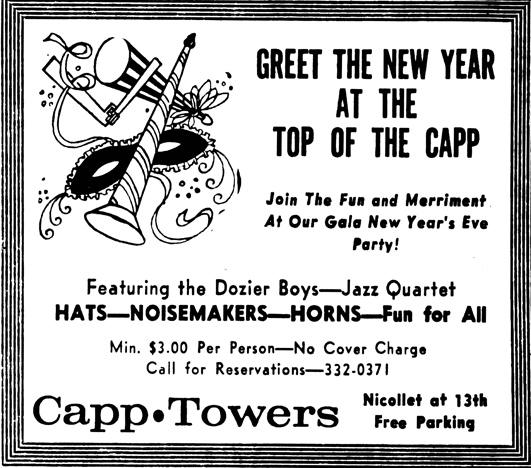
Minneapolis Star, December 28, 1963

Minneapolis Star, November 27, 1964
STARLITE ROOM
From the looks of it, this was the Top of the Capp with a new name.
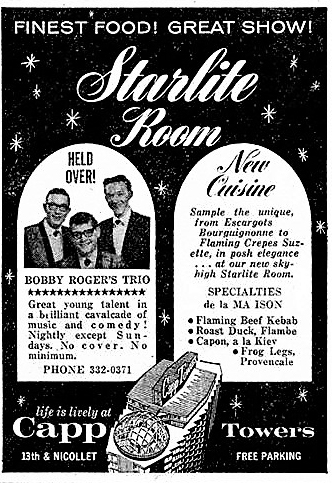
October 14, 1965
BRANDYWINE BAR
Will Jones said the room, basically a piano bar, “with its Roman arches and wild stained glass windows by Bill Saltzmann, looks like a monastery for swingers and you almost wish the drinks were served by jolly fat monks instead of regular bartenders in red jackets.” A 1963 ad cited “the atmosphere of an early French wine cellar.”
BLUE BAR
This was “a unique stag bar for men only, 11 am to 4:30 pm. Ladies welcome after 4:30 pm.”
CARIBBEAN ROOM AND POOL
Appearing nightly in July 1963 was Sir Lancelot, world’s finest calypso singer, Hollywood and television star.”
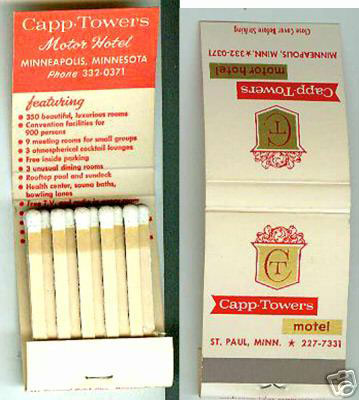
The hotel went through several subsequent iterations:
REGAL MINNEAPOLIS HOTEL
PARK INN
HOLIDAY INN CENTRAL
This was the place celebrities stayed. Music venues included:
PIERRE’S
1968: Riverboat Ramblers with Jane Riley and Pierre’s girls.
March 1969: Riverboat Ramblers featuring Holiday in Sun Valley and Louise Drake
June 1969: Holiday in Haight Ashbury – featuring songs from Hair.
1974: “Adult swinging singles every Friday night with the best big bands in the Twin City area.”
STARLITE ROOM
1969: Tommy O’Donnell Trio, featuring Jane Riley, vocalist
LITTLE FOXES LOUNGE
March 1969: Roy Thies, Flamenco guitarist
MILLENNIUM HOTEL MINNEAPOLIS
Last I checked it was still owned by the Capp family.
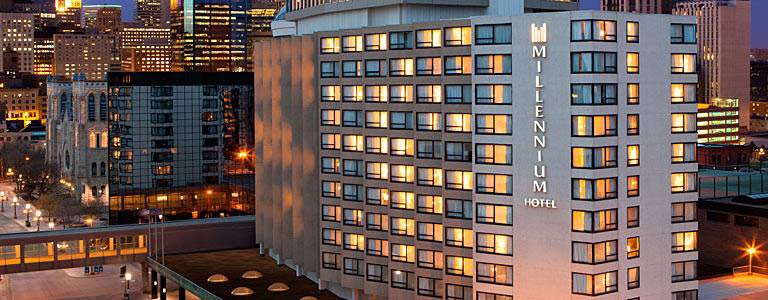
The Capp Towers in St. Paul was located at 77 – 9th St. E. at Minnesota.
It has eight stories and was built in 1959.
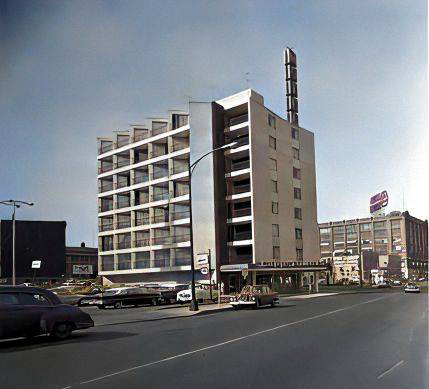
May 4, 1961 Photo courtesy Minnesota Historical Society
KDWB TAKEOVER
Race riots and curfews in Milwaukee brought the Monkees to Minneapolis a day early, so on Friday, August 4, 1967 [right after our own race riot], KDWB arranged for them to take over the airways on the afternoon before their concert at the St. Paul Auditorium. A remote was set up at their hotel, the Capp Towers Motor Hotel at 9th and Minnesota in St. Paul. Although the location was announced as “Secret City,” there was a crowd of screaming girls outside listening to their transistor radios.
There’s more about the Monkees in St Paul.
John Mannillo reports that
The owner of Capp Towers for many years was Earl Scott. His manager was George. I can’t remember his last name. I believe George now manages Hazeltine Golf Club. They were big hockey fans during the Fightin’ Saints era. Earl, better known as Scotty, owned an old fire truck which he gave rides on whenever he could.
This accounts for the restaurant called the Firehouse.
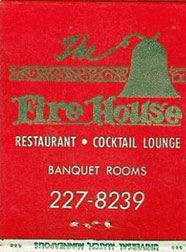
There was also a restaurant called Scottie’s.
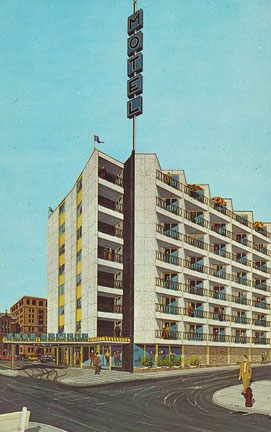
John Mannillo again:
I was the real estate broker who represented the Union Gospel mission (I think in the late 1980s) on the purchase of the building from Earl Scott. They purchased this property which was mostly under utilized and in need of substantial repair, for the now Naomi Family Center.
The Naomi Family Residence, a residential program for women and women with children, provides food, clothing, 25 life skill classes, and Bible studies and is operated by the Union Gospel Mission.
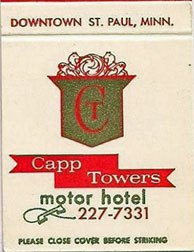
Ramada Inn, 494 and France. 1973 featured the Johnny Ricco Show.
The Carioca Cantina was located at 124 State Street in St. Paul.
A previous building with that address was destroyed by fire in 1905. (St. Paul Globe, February 3, 1905) Lyfmap.com seems to indicate that the building was rebuilt in 1926.
CARIOCA CANTINA
The story of the Carioca Cantina comes right from Junior Trejo, the son of the owner and originator of the bar and restaurant. Thank you, Junior, for this wonderful account of your dad’s bar and the beginning of your own career!
The year was about 1960 and my father, Louis Trejo Sr,. was 27 when he bought his first business. It was a pool hall and bar and he called the “Carioca Cantina” which was located down in the west side which was known as the “West Side Flatts.” If any of you know St. Paul, it’s where the industrial park is now next to the Mississippi River.
I was seven years old when I started playing professionally on weekends at the bar, playing Tejano music with some of my uncles and the musicians my dad hired. I remember my mother and father bought me sticks, snare drum, and stand at about three going on four, and I remember I caught the snare on the stand and ripped the bottom skin. All my Uncles were musicians, including my dad who played trumpet, but got into a motorcycle accident and had to stop cuz he knocked out his front teeth. So that’s where the interest and the journey started was from my family.
Not sure who the kids are in the picture below, but if you zero in you can see the name of my dad’s bar on the front.
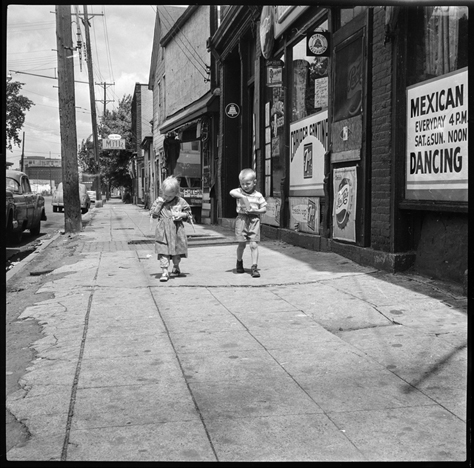
1962 photo courtesy Minnesota Historical Society
The picture below is “Pepe Carioca,” the parrot which was my dad’s logo for the bar, and check this out….instead of having signs painted on his 1956 Ford pickup truck he actually mounted them on to the doors.!!. You go dad!! My dad was really into advertising.
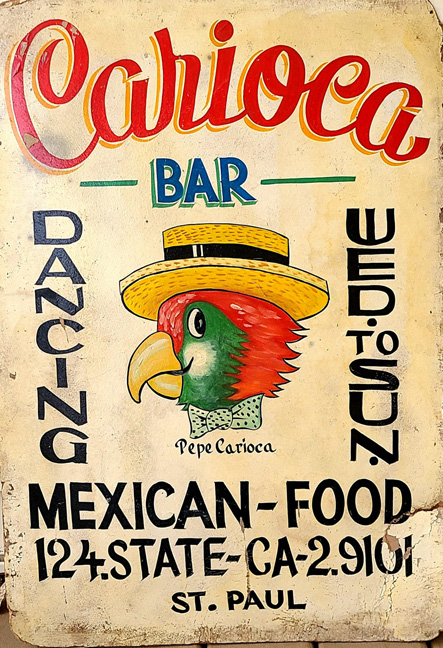
Image courtesy Junior Trejo
The pictures on the bottom are of me playing one night at the bar and it was so funny cuz grown ups would walk by my drum set and think how cute I was playing being so young and reach in their pockets and throw me some money! Most of the time I made more money than the musicians.
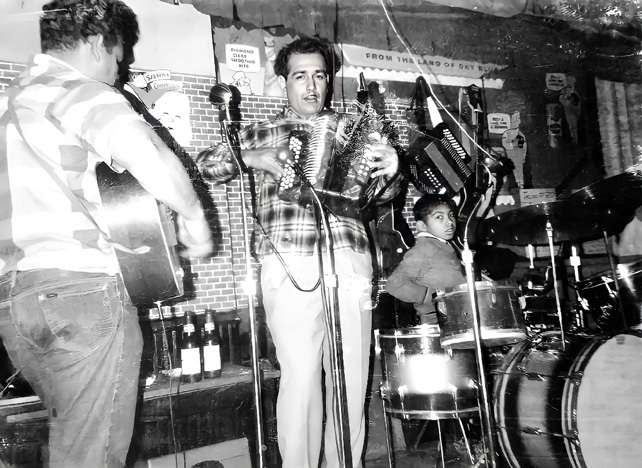
Image courtesy Junior Trejo
The color picture was enhanced by my friend Gabriel Rios.
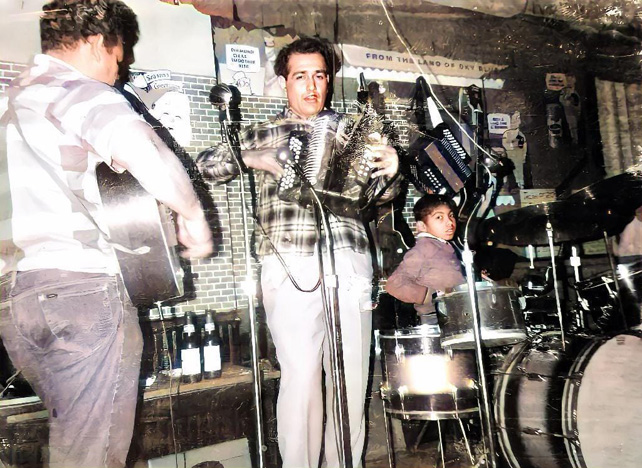
Image courtesy Junior Trejo
Here’s a funny part of the story is that I was the fill-in drummer when they couldn’t find somebody but the musicians used to tell my father that they liked playing with me because I was pretty steady for being seven years old except every now and then they would laugh because they’d start playing mostly the last set and I wouldn’t be on the drum set because I would be too tired probably cuz it was midnight and just walk off and head towards the bar where my dad had made me a little bed underneath and go to sleep!
Wow!! Thank the Lord for watching over me on this crazy journey but let me tell you…..I’ve had a wonderful life so far and the best is yet to come. With many stories to tell and maybe one day I’ll take the time and write a book. I think it would it be called something like……”I was only seven when my dream became REALITY!!”
Well, it’s silly to include these little 1934 taverns that came and went after the end of Prohibition, but I think they’re fun. I only found three ads for this one – two had music by Eddie’s Little German Band, and the other was Art and His Dutch Boys.
But what’s this? Looks like Herr Carlson owned this and the High Hat, and they were both at Third and Hennepin. I’ll get to the High Hat presently.
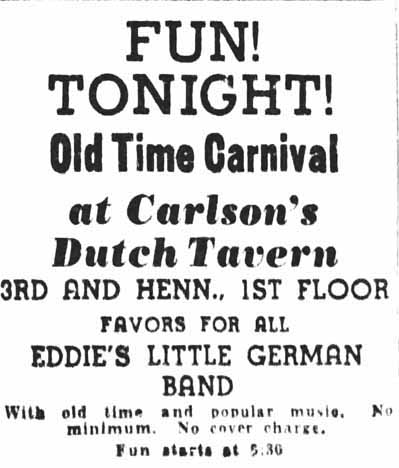
Minneapolis Tribune, October 3, 1934
This venue, active between 1979 and 1987, was totally off my radar, A) because it violates my 1974 cut-off date for this site, and B) I didn’t live in the ‘Cities in the ’80s. But there were some fabulous acts that performed there, so I’ll break my rule. There are way more than I expected, so this is still a very incomplete list.
The Carlton Celebrity Dinner Theater was located at 8350 24th Ave. So. It was built in 1961 as a venue for the National Bowling League, which was only active from 1961-1962. It was built with a terraced spectators’ section. Our Twin City Skippers competed in the League, before it went bankrupt in 1962. (Ken Anderson)
The building sat vacant for almost 18 years until it was finally repurposed by Carl G. Berndt, who had operated two other Carlton Inns in Wisconsin. He was the co-owner of this third one, possibly with Kenneth Olson, who was from a furniture store background and was in the real estate business.
The wedge-shaped auditorium held about 2,200 people: 1,270 in the terraced dinner level and 920 in the balcony. In addition to the main room, there was the Backstage Room, which featured up-and-coming acts, many of which went on to become stars. It has also been described as a disco and semi-private club. There was also the All-Star Lounge.
In 1983 the Carlton built a three-story addition to create a new Las Vegas Room and Marquee Room to facilitate banquets and meetings.
From 1983 to 1986, the Carlton was also the location of the Minnesota Music Awards.
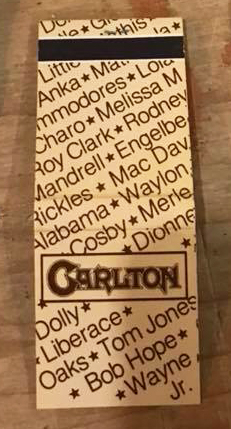
Photo by Jeff Johnson
SHOWS AT THE CARLTON
Please note that show dates are taken from ads and shows may have been postponed or cancelled.
1979
- Mel Tillis, February 23 – March 3, 1979 – first act
- Rocco Ferrante Organ Concert, March 22, 1979
- Pat Boone with the Ben Arden Orchestra, March 23 – 31, 1979. Apparently the Ben Arden Orchestra was the new house Big Band and the Pat Boone show was the first time it was used. One member said that the performers would often leave the band members gifts, such as bottles of wine. Bob Newhart left them bottles of Dewars Scotch!
- David Brenner with Edna Lev, April 20 – 28, 1979
- Mills Brothers, May 4 – 12, 1979
- Freddie Fender, May 18 – 19, 1979
- Blood, Sweat and Tears, May 31 – June 2, 1979
- Connie Stevens, June 8 – 16, 1979
- Superpickers, June 17, 1979
- Kingston Trio, June 28 – 30, 1979 (Bob Shane was the only original member)
- Frank Gorshin, replacing Joan Rivers, July 13 – 21, 1979
- Jerry Lee Lewis, July 6 – 7, 1979
- Conway Twitty, July 27 – 28, 1979
- James Brown and the JB’s, Willie and the Bumblebees, July 29, 1979. People complained about the $2 cost to park. Brown showed up that Saturday at the Union Bar and played with the Lonnie Brooks Band.
- Lesley Uggams, August 3 – 11, 1979
- Rodney Dangerfield, August 17 – 24, 1979
- Bill Anderson, August 31 – September 1, 1979
- Faron Young, September 7 – 9, 1979
- Mills Brothers, September 14-20, 1979
- Lettermen, September 21 – 29, 1979
- Seals and Crofts, October 5 – 13, 1979
- Danny Thomas, replacing Joan Rivers, October 19 – 27, 1979
- Charley Pride, November 2 – 3, 1979
- Mel Tillis, November 9 – 18, 1979
- Ben Vereen, November 23 – 30, 1979
- Sandler and Young, November 30 – December 3, 1979
- Bobby Goldsboro, December 7 – 9, 1979
- James Darren with Fred Travelena, December 14 – 22, 1979
- Sandler and Young, December 28 – 31, 1979
1980
- Lola Falana, January 11 – 19, 1980
- Loretta Lynn, January 25 – February 2, 1980
- Oak Ridge Boys, February 8 – 16, 1980: Drew 16,000 people
- Joan Rivers, February 22 – March 1, 1980
- Robert Goulet and Marty Allen, March 4 – 9, 1980
- Charo, March 11 – 16, 1980
- Rodney Dangerfield, March 21 – 29, 1980
- Eddie Rabbit, Dottie West, April 8 – 13, 1980
- Roy Clark, April 16 – 20, 1980
- Mills Brothers, April 22 – 30, 1980
- David Brenner, May 2 – 10, 1980
- Julius Wechter and the Baja Marimba Band, May 15 – 18, 1980
- Pat Boone, May 22 – 25, 1980
- Ronnie Milsap, May 29 – June 1, 1980
- Kingston Trio, June 5 – 7, 1980
- Rich Little, June 13 – 18, 1980
- Bob Newhart, June 20 – 28, 1980
- Mac Davis, July 10 – 15, 1980
- Conway Twitty, July 23 – 26, 1980
- Frankie Laine and Patti Page, August 1 – 9, 1980
- Tina Turner and Fred Travelena, August 15 – 23, 1980
- Bob Hope, August 26 – 31, 1980
- Tom Jones, September 9 – 14, 1980
- Dom DeLuise, September 19, 20, 25-27, 1980
- Mills Brothers, October 3 – 11, 1980
- Mel Tillis, October 19, 1980: Benefit for the Twin Cities Diabetes Association raised $75,000
- Mel Tillis, October 20 – 26, 1980
- Lettermen, October 31 – November 8, 1980
- Charley Pride & Janie Fricke, November 12 – 16, 1980 [Don Williams]
- Mitzi Gaynor, November 21 – 29, 1980
- Oak Ridge Boys, December 2 – 13, 1980
- Sandler and Young, December 16 – 21, 1980
The Backstage Disco became the Backstage Lounge in 1980
- Whisper, May 1 – 4, 1980
- Ric Evans and the Reflections, May 6 – 11, 1980
- Muglestons, May 13 – 18, May 25, 1980
- Whisper, May 20 – 29, 1980
- Wright Bros., May 30 – June 7, 1980
- Italian 5 Plus 1, June 11 – 29, 1980
- Facts of Five, July 1 – 17, 1980
- Steve Miller & Diamondhead, July 18 – August 2, August 5-31, 1980
- Muglestons, August 26 – September 7, 1980
- Lloyd Owens, September 9 – September 21, 1980
- Betty Rydell, September 23 – October 5, 1980
- Memories, October 7 – October 19, 1980
- Colleagues, October 21 – 22, 1980
1981
- Roger Williams and Robert Goulet, January 1 – 4, 1981
- Johnny Cash with Frankie Bush, January 7 – 10, 1981
- Engelbert Humperdinck cancelled
- Harry Chapin, January 13 – 14, 1981
- Sammy Davis, Jr., January 16 – 18, 1981
- Debbie Boone and Fred Travelena, January 23 – 31, 1981
- Roy Clark, February 6 – 14, 1981 [10 – 15]
- Bobby Vinton, February 20 – 21, 1981
- Loretta Lynn, February 27 and March 7, 1981
- Ben Vereen, March 13 – 21, 1981
- Stars of the Grand Ole Opry, March 24 – 29, 1981
- Lola Falana, March 31 – April 5, 1981
- Beatlemania, April 14 – 19, 1981
- Don Williams, April 22 – 25, 1981
- Don Rickles, April 19 – May 2, 1981
- Rich Little, May 5 – 10, 1981
- Rodney Dangerfield, May 21 and 22, 1981
- George Jones & Tammy Wynette, May 26 – 31, 1981
- Lou Rawls, June 2 – 6, 1981
- Captain & Tenille, June 25 – 27, 1981
The Celebrity Room was closed during the week of June 29, 1981, for construction of the three-story addition.
- Mel Tillis had been scheduled for July 3 – 4, but was rescheduled for December 17 – 18 due to delays in construction.
- Mac Davis, July 7 – 12, 1981
- Barbara Mandrell, July 16 – 17, 1981
- Mickey Gilley/Johnny Lee and the Urban Cowboy Band, July 18 – 19, 1981
- The Original Three Dog Night/Michael Johnson, July 23 – 25, 1981
- Tom Jones, July 28 – August 2, 1981
- Charlie Rich/Gail Davies, August 6 – 8, 1981
- Dinah Shore, August 11 – 15, 1981
- Roy Orbison, August 16, 1981 ONLY
- James Brown, August 19, 1981 ONLY
- Harry Chapin, August 21 – 22, 1981
- Oak Ridge Boys, August 25 – 30, 1981
- Bob Hope, September 1 – 6, 1981. September 1 was designated “An Evening With Hope” was a benefit for the Methodist Hospital Foundation. On September 6, Hope was presented in his dressing room with a plaque from the Enlisted Association of the National Guard of the United States (EANGUS). At the time their National Secretary Master Sergeant Anthony Nathe.
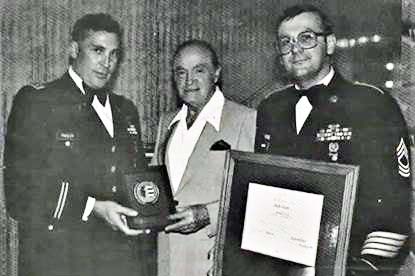
Major Duane D. Paisley, Bob Hope, and Master Sergeant Anthony R. Nathe. Photo courtesy Anthony R. Nathe
- Tanya Tucker, September 10 – 12, 1981
- Conway Twitty/Lacy J. Dalton, September 16 – 19, 1981
- Larry Gatlin and the Gatlin Brothers Band, September 28 – October 3, 1981
- Suzanne Somers, October 6 – 10, 1981
- Dolly Parton, October 15 – 20, 1981
- Joan Rivers/David Brenner, October 21 – 25, 1981
- Stars of the Grand Ole Opry, October 27 – November 1, 1981
Pictured in the ad for the Stars of the Grand Ole Opry Show were:
-
-
- Bill Anderson
- Jimmy C. Newman & Cajun Country
- Jean Shepard & the Second Fiddles
- Del Wood
- Wilma Lee Cooper & the Clinch Mountain Clan
- Lonzo & Oscar
- The Tennessee Travelers with Melvin Sloan
-
- Carol Channing, November 3 – 7, 1981
- Maynard Ferguson, November 8, 1981
- George Carlin, November 10 – 11, 1981
- Marty Robbins, November 12 – 14, 1981
- T.G. Sheppard, November 20 – 21, 1981
- You’re a Good Man, Charlie Brown, November 22 – 24, 1981
- Tony Bennett/Peggy Lee, November 27 – December 5, 1981
- Andy Williams, December 8, 1981 – Benefit for the Boys Club of Minneapolis – raised $83,000
- Andy Williams, December 9 – 13, 1981
- Mel Tillis and the Statesiders, December 17 – 19, 1981
Backstage 1981
When the Carlton opened, the Backstage was originally a disco, but it never really caught on, so in the winter of 1980/1981 it was remodeled into a 250 seat lounge to showcase Country acts. Jon Bream described it as a multi-tiered room tucked under the balcony of the Celebrity Room. The stage is on the top/third level, with a bar on the first level and tables and chairs on a lower level where dinner is served. It opened in January 1981. (Minneapolis Star, April 10, 1981)
The Backstage featured “Tuesday Nights Live” and remote spots on WDGY, then a Country station. “Beefeater” Shows were priced from $9.95, and “Nightcap” Shows started at $4.95.
- Helen Cornelius, January 13 – 18, 20 – 21, 1981
- Wright Brothers, January 22 – 24, 27 – 31, February 3 – 7, 1981
- Billy “Crash” Craddock, February 10 – 15, 1981
- Dave Rowland & Sugar, March 10 – 15, 17 – 22, 1981
- Alabama, March 23 – 28, 1981
- Jerry Lee Lewis, March 31 to April 5, 1981
- Thrasher Brothers, April 7 – 12, 14 – 19, 1981
- Soupy Sales, April 21 – May 2, 1981
- Louise Mandrell, May 5 – 9, 1981
- Bellamy Bros., May 12 – 17, 1981
- John Conlee, May 19 – 24, 1981
- The Treniers, May 26 – June 7, 1981
- The Kingston Trio, June 9 – 14, 1981
- Buddy Greco, June 16 – 21, 1981
- Four Aces, June 23 – 28, June 30 – July 5, 1981
- Wright Brothers, July 7 – 11, 14 – 18, and 21 – 25, 1981
- Baja Marimba Band, August 11 – 16, 18 – 22, and 25 – 26, 1981
- Tompall & the Glaser Brothers, October 27 – 31, 1981
- Jeanne Pruett, November 3 – 7, 10 – 14,1981
- Wright Brothers, November 17 – 21, 24 – 28, December 1 – 5, 1981
- Kenny Burrell, December 8 – 12, 1981
- Terri Gibbs, December 15 – 19, 1981
- Paul New & Steel City, December 29, 1981 – January 2, 1982
1982
- The Association, December 31, 1981 to January 2, 1982
- Gladys Knight and the Pips, January 7 – 9, 1982 – First Twin Cities Appearance
- Johnny Cash, January 13 – 16, 1982
- Alan King, January 21 – 23, 1982
- Don Williams, February 18 – 21, 1982
- Sha-Na-Na, March 5 – 7, 1982 [4 – 6]
- The Rovers, March 18 – 20, 1982
- Tom Jones, March 23 – 28, 1982
- Loretta Lynn, March 31 – April 4, 1982
- Buddy Rich and His Band, April 21, 1982
- Frankie Avalon’s Rock ‘n’ Roll Revival with Bo Diddley, Freddie Cannon, and the Coasters, April 22-24, 1982
- Louise Mandrell, April 29 to May 1, 1982
- Johnny Mathis, May 11 – 16, 1982
- Rodney Dangerfield, May 21-22, 1982
- Engelbert Humperdinck, June 10 – 13, 1982
- Roy Orbison, June 18 – 20, 1982
- The Spinners, August 13 – 14, 1982
- Liberace, August 17 – 22, 1982
- Ray Price, August 27 – 28, 1982
- Roy Orbison, September 2 – 4, 1982
- Eddy Arnold, September 9 – 11, 1982
- Dolly Parton, September 15 – 18, 1982
- Englebert, September 22 – 26, 1982
- Merle Haggard, September 30 – October 2, 1982
- Don Rickles, October 7 – 10, 1982
- Lou Rawls & Marilyn McCoo, October 13 – 16, 1982
- Tony Orlando, October 28 – 30, 1982
- Roy Clark, November 4 – 6, 1982
- Gladys Knight & the Pips, November 11 – 13, 1982
- Bobby Vinton, November 18 – 20, 1982
- Chameleon, November 24, 1982
- Oak Ridge Boys, November 26 – 28, 1982
- Maynard Ferguson, November 29, 1982
- Rich Little, December 1 – 4, 1982
- Dionne Warwick, December 6 – 11, 1982
- The Kingston Trio, December 12 – 13, 1982
- George Jones, December 16 – 19, 1982
- Sandler & Young, December 29 – 31, 1982
Backstage Dinner Theater, 1982
- Paul New and Steel City, December 29, 1981 to January 2, 1982
- Calamity Jayne, January 5 – 9, 1982
Something called the Good Humor Snackbar had been added to the Backstage, featuring Don Taft and Friends. “Good Tunes, Good Times.” Sounds like a Piano Bar. The photo below is bad, but is that a monkey?
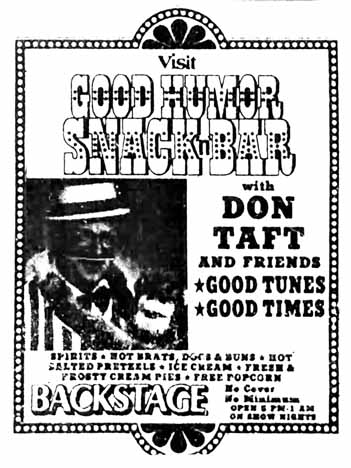
Minneapolis Tribune, August 8, 1982
1983
- Dolly Parton, January 5 – 8, 1983
- George Carlin, January 21 – 22, 1983
- Three Dog Night with special guest the Grass Roots, January 28 – 29, 1983
- Mickey Gilley and the Urban Cowboy Band, February 3 – 5, 1983
- Andy Williams, February 10 – 12, 1983
- Bill Cosby, February 18 – 19, 1983
- The Pointer Sisters, February 24 – 26, 1983
- Bob Hope, March 25 – 26, 1983. Anthony R. Nathe, SGM, US Army-Retired sent the photo below of the presentation of an 80th Birthday cake to Hope on stage (he turned 80 on May 29, 1983). The cake it was donated by Supermom’s Bakery. Pictured are Governor Perpich , Miss Minnesota, Nate (in the Military uniform), Rodger Brodin (Vietnam Statue Sculptor, standing behind Nathe), Dan Ojeda, Jr. in white jacket (Four Seasons Awards), and Bob Hope.
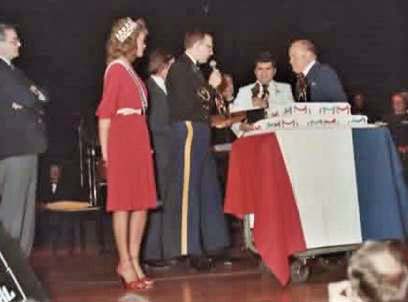
Photo courtesy Anthony R. Nathe
- The Gatlin Bros., March 31 – April 2, 1983
- John Davidson, April 10, 1983
- Loretta Lynn, April 21 – 24, 1983
- Johnny Cash, May 4 – 7, 1983
- Minnesota Music Awards, May 16, 1983
- Rodney Dangerfield, May 20-21, 1983. A witness says that Rodney was picking on Verne Gagne, who was in the audience.
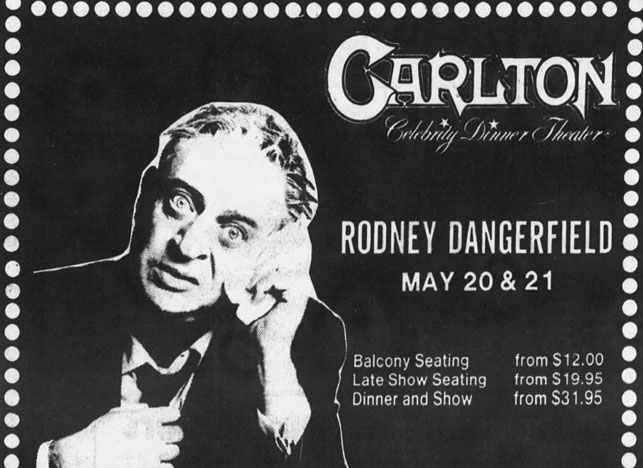
- Don Williams, May 25 – 28, 1983
- Kool and the Gang, May 29, 1983
- Danny Thomas, June 9 – 11, 1983. June 9’s performance was a benefit for the Make a Wish Foundation.
- John Conlee, June 12, 1983
- Swedes in Town, June 15, 1983
- Conway Twitty, June 16 – 18, 1983
- Gladys Knight and the Pips, June 24 – 25, 1983
- Pure Prairie League, opened by Rue Nouveau, June 26, 1983. Gary Rue of Rue Nouveau remembered: “We went backstage to the lounge immediately after our set, and PPL’s manager came back and said: “I look at you guys, and I think “Flock of Seagulls.”
- Mac Davis, June 29 – July 2, 1983
- Melissa Manchester – July 5 -6, 1983
- Don Rickles, July 15 – 16, 1983
- BJ Thomas, July 19, 1983
- Ray Price, July 22 – 23, 1983
- Ronny Robbins, July 31, 1983
- Sha-Na-Na, August 5 – 6, 1983
- Merle Haggard, August 11 – 13, 1983
- Ronnie Milsap, August 14, 1983
- Laura Branigan, August 17, 1983
- Wayne Newton, August 22 – 28, 1983
- Johnny Mathis – Postponed
- Jerry Lee Lewis with Paul Revere and the Raiders, August 31 to September 3, 1983
- James Brown with Mary Wilson and the Supremes, September 8 – 10, 1983
- Helen Reddy, September 22, 1983
- Roy Orbison, September 23 and 24, 1983
- Smokey Robinson, September 27 and 28, 1983
- Roberta Flack, September 30 to October 1, 1983
- Johnny Mathis – Postponed
- Eddie Rabbit, October 6 – 7, 1983 (October 6 cancelled)
- Maynard Ferguson, October 8, 1983
- Ricky Skaggs and the Whites, October 14 and 15, 1983
- Charlie Daniels, October 17 and 18, 1983
- Charlie Pride, October 20 – 22, 1983
- Liberace, October 25 – 30, 1983. This year’s show featured Shani Wallis, Rick and Barbara, and Dancing Waters.
- The Commodores, November 3 – 5, 1983
- Andy Gibb, November 11 – 12, 1983
- Ronnie Milsap, November 13 – 14, 1983
- Lefty Frizzell and Dottie West, November 18 – 19, 1983
- Waylon Jennings & Jessi Colter, November 25 – 26, 1983
- Phyllis Diller with Jerry Vale, December 1 – 4, 1983
- Oak Ridge Boys with Williams and Ree, December 7 – 11, 1983
- Tony Bennett with the Woody Herman Orchestra, December 13 – 18, 1983
- The Ink Spots, December 20 – 23, 1983
- Lee Greenwood with Terry Gibbs, December 28 to 30, 1983
- Marilyn Sellars and the Dick Whitbeck Orchestra, December 31, 1983
Backstage, 1983
- Prince, May 16, 1983
- Crosswind, May 20 – 21, 1983
- Crosswind, June 16 – 18, 1983
- Crosswind, July 5 – 6, 15 – 16, 22 – 23, 30 – 31, 1983
- Crosswind, August 11 – 13, 17, 22 – 28, 31, 1983
- Crosswind, September 1 – 3, 9 – 11, 23 – 24, 27 – 28, 30, 1983
- Crosswind, October 1, 7 – 8, 14 – 15, 17 – 18, 20 – 22, 25 – 30, 1983
- Crosswind, November 4 – 5, 11 – 14, 18 – 19, 25 – 16, 30, 1983
- Crosswind, December 2 – 3, 7 – 11, 15 – 18, 1983
Thank you to Dale Schultz for the dates for Crosswind!
1984
- Don Rickles, January 13 – 14, 1984
- Mickey Gilley, January 19 – 21, 1984
- Sammy Davis, Jr., January 27 – 29, 1984
- Jerry Jeff Walker, February 12, 1984
- Mel Tillis, February 24 – 25, 1984
- James Brown, February 26, 1984
- Blackstone (Magician), March 9 – 10, 1984
- Englebert, March 14 – 17, 1984
- John Conlee, April 1, 1984
- Leon Russell, April 29, 1984
- Eddie Rabbitt, May 18 – 19, 1984
- Minnesota Music Awards, May 21, 1984
- Johnny Mathis, May 23, 1984
- Don Williams, June 13 – 16, 1984
- Perry Como, June 19 – 24, 1984
- B.J. Thomas, June 25 – 26, 1984
- Hank Williams, Jr., June 28 – 29, 1984
- Roy Orbison, June 30, 1984
- Mills Brothers and Patti Page, July 11 – 14, 1984
- Crystal Gayle, July 19 – 21, 1984
- Ronny Robbins, July 22, 1984
- Little River Band, August 17-18, 1984
- Conway Twitty, September 6 – 8, 1984
- Bill Cosby, September 14 and 15, 1984
- Kool and the Gang, September 21 and 22, 1984
- Johnny Cash with Marty Stuart, September 26-29, 1984
- Roy Clark, November 9 – 10, 1984
- Sandler and Young, December 28 – 31, 1984
Backstage, 1984
- Crosswind, January 6 – 7, 1984
- Wright Brothers, April 11 – 14, 1984
- Prince, May 21, 1984
1985
- Janie Fricke and Exile, January 12 – 13, 1985
- Mac Davis, May 31 – June 2, 1985
- Johnny Mathis with Jeannine Burnier, June 5 – 9, 1985
- Rodney Dangerfield, June 12 – 15, 1985
- Tony Orlando, June 20 – 22, 1985
- Ricky Skaggs, June 28 – 30, 1985
- Ray Charles, July 3, 1985
- Donny & Marie Osmond, July 5 – 6, 1985
- Marshall Tucker Band – July 7, 1985
- Mickey Gilley, July 26 – 27, 1985
- Sammy Davis, Jr. with Suzette Charles, (1984 Miss America), August
- George Burns, September 10 – 15, 1985
- Minnesota Black Music Awards, September 26, 1985
- Mel Tillis and Reba McEntire, October 5 – 6, 1985
- B.J. Thomas and the Judds, October 8 – 9, 1985
- Charlie Pride, October 18-20, 1985
- Debbie Reynolds, October 23 – 26, 1985
- Eddie Rabbitt, November 1 -2, 1985
- Pearl Bailey with Louie Bellson, November 7 – 8, 1985
- Connie Francis, November 9 – 10, 1985
- Crystal Gayle, November 14 – 16, 1985
- The Temptations and the Four Tops, November 30 – December 1, 1985
- Johnny Cash with June Carter Cash, December 4 – 7, 1985
- Manhattan Transfer, December 17 – 22, 1985
- Oak Ridge Boys with Williams and Ree, December 10 – 15, 1985
Backstage, 1985
- Three’s Comedy: Alex Cole, Joel Madison, Sid Youngers, with Tom Baumgartner, Tom Arnold, Mike Lewis, and Dean Johnson. Also appearing: Tom Arnold, Tom Baumgartner, Mike Lewis, and Dean Johnson – May 23 – June 1, 1985.
- All Pro Comedy Show, with Alex Cole, Joel Madison, Sid Youngers, and Susan Voss – June 6, 1985
- Paul Rodriguez, July 19 – 20, 1985
- Henny Youngman, August 9 – 10, 1985
- Jerry Lee Lewis, August 12, 1985
- John Waite, September 1985
1986
- Roy Clark, January 10 – 11, 1986
- Larry Gatlin & the Gatlin Brothers, January 23 – 25, 1986
- Lee Greenwood, February 13 – 16, 1986
- Johnny Cash, May 1 – 3, 1986
- Minnesota Music Awards, May 20, 1986
- Tony Bennett, July 18 – 19, 1986
- The Monkees 20th Anniversary Show, with Gary Puckett, Herman’s Hermits, and the Grass Roots, August 20-22, 1986
Backstage, 1986
- Prince, May 20, 1986
1987
- Chuck Berry, January 1, 1987
- The Allman Brothers with the Dickey Betts Band, January 31, 1987
- Johnny Cash, April 1-4, 1987
- Arlo Guthrie, May 1, 1987
- David Brenner, May 2, 1987
- Jerry Lee Lewis and Roy Orbison, May 8 – 9, 1987
- Wayne Newton, May 20 – 24, 1987
- Swinging Ambassadors 20th Anniversary Show, June 4, 1987
- Ray Charles, June 18, 1987
Other shows that folks remember include:
- The Mitzi Gaynor Review
- Jose Feliciano
- Gallagher
- Spandau Ballet
The Carlton went bankrupt in 1986 and was razed for the Mall of America in 1987.
FARGO
The Carlton was immortalized in the Coen Brothers film “Fargo,” when Carl Showalter (Steve Buscemi) brings a date to see José Feliciano. The scene was actually staged in the Chanhassen Dinner Theater.
Know any others or have any memories of the place? Contact me!
Anoka
26 West Lake Street, Minneapolis. This venue was in an ad for a dance in 1923 in the Northwestern Bulletin. The site is now a Super Valu Store.
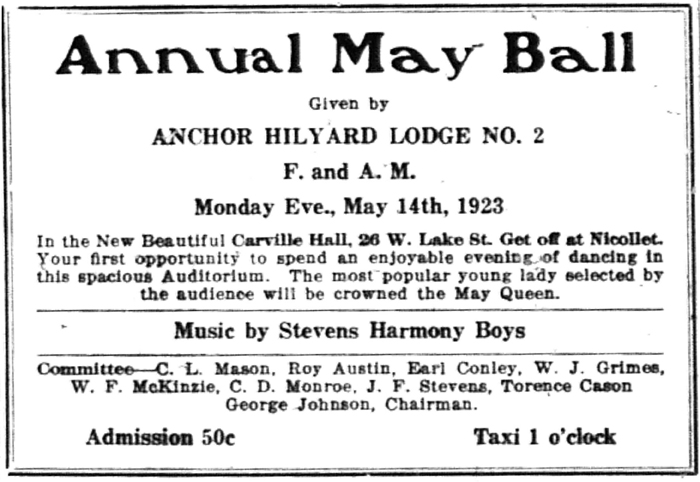
1830 E. Franklin at Cedar. February 1942: Ward Mitchell, proprietor (also owned Ward Mitchell’s Beer Tavern). Not sure the Casa-Loma had entertainment, but with that name it certainly should have!
The Casanova Cafe and Lounge was located at 43-45 So. Fourth Street (across from Maurice L. Rothschilds) on Newspaper Row, appropriate because it was a part of the Minneapolis Journal Building, apparently built in 1889. One half, number 45, was the bar, and one half was the cafe. Together they measured 44 ft. x 150 ft. and the building was three stories tall.
THE CASANOVA BAR
The Casanova Bar, at 45 S. Fourth Street, opened on May 11, 1940, according to an announcement in the Minneapolis Star.

Minneapolis Tribune, May 19, 1940
The owners were Warren Kirk and “Bill” Corbett. Next door at 43 So. Fourth Street was Kirk’s Restaurant, “a Newspaper Row institution for the past twenty-five years,” which would bring it back to 1915. One mention said it started in half of a basement. Kirk was the first person in Minneapolis to apply for a 3.2 beer license on March 15, 1933 – beer became legal to sell on April 8, 1933.
The new Casanova bar featured a long bar and cozy booths,
where confidential matters may be discussed, as such matters should be, over the table. For those who like to sit out in the open to see and be seen, a long row of tables and comfortable chairs are available. Artistically decorated in a color scheme that soothes and relaxes, the New Casanova is bathed in soft lights, effecting an atmosphere in which the original Casanova himself would have been delighted to have been submerged. (Minneapolis Tribune, May 19, 1940)
The official Grand Opening was held on May 21 and 22, 1940. References to Kirk’s Restaurant disappeared after that, so they must have merged soon afterwards.
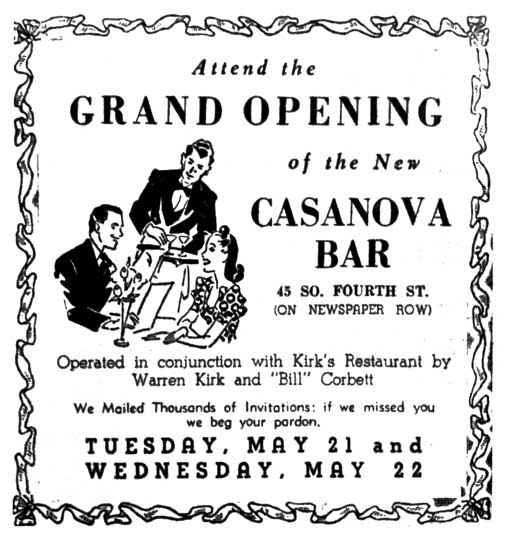
Minneapolis Tribune, May 21, 1940
There were several small ads like the one below. This was the last one found.
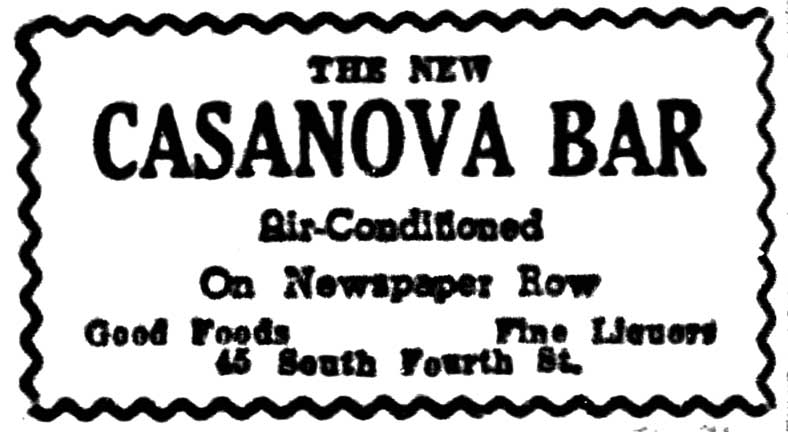
Minneapolis Tribune, September 10, 1940
TOMMY EWING
Although no announcement was found, Thomas E. Ewing became the proprietor of the business and holder of the liquor license. Ewing operated as President of Casanova Bar, Inc. The gangster Tommy Banks was accused of owning the bar, which he couldn’t because of his criminal record, but Tommy did admit that he loaned $10,000 to Ewing for startup money.
Tommy Banks and Harry Shepard purchased the building on December 13, 1943, through attorney Simon Meshbesher.
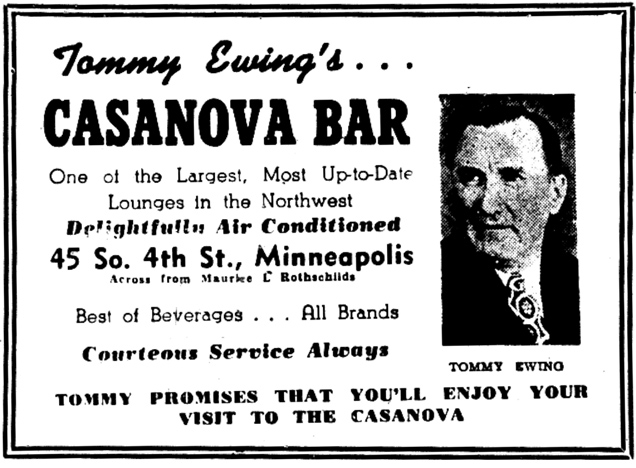
November 17, 1943
The house specialty was “Chicken in the Rough,” served unjointed, with no silverware.
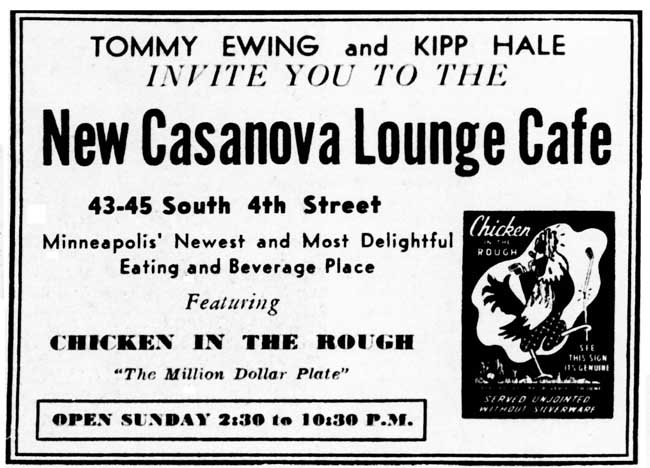
Minneapolis Tribune, March 4, 1944
THAT SIGN!
The Casanova had one of the most spectacular lighted signs in Downtown Minneapolis. The ad below boasted that the sign had 21 Transformers with 1,840 Bulbs and 1,540 feet of Fluorescent neon Tubing. According to permit cards, the lights went up in March of 1945.
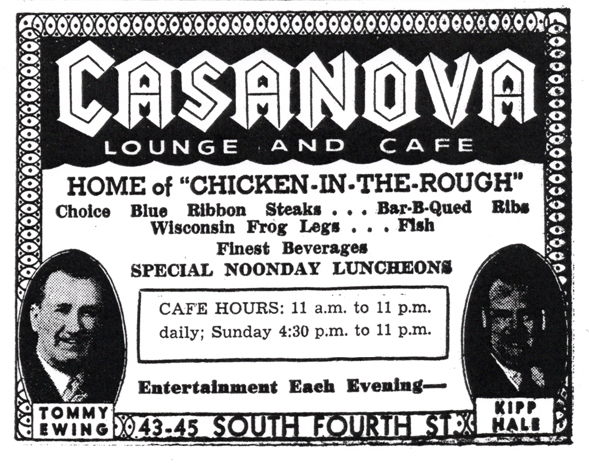
St. Louis Park Dispatch, April 20 and 27, 1945
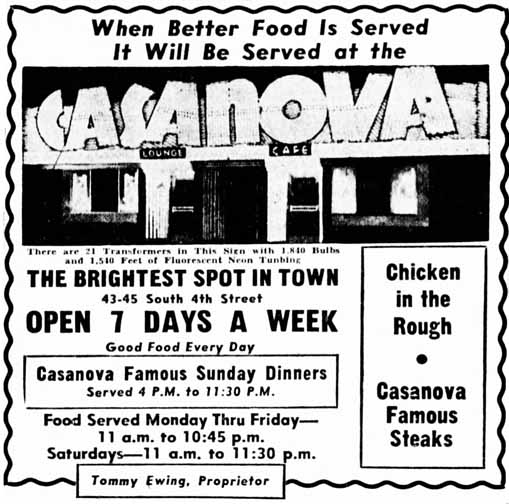
Minneapolis Tribune, November 13, 1946
THE BUILDING IS SOLD
On January 17, 1947, it was revealed that Tommy Banks and his wife Reta Banks sold the building to the B and S Co. for approximately $15,500. The quit claim deed was filed on December 15, 1946. According to the articles of incorporation filed in 1943, the incorporators of the B and S Co. were:
- Harry Shepard, Maryland Hotel, 1346 LaSalle Ave
- R.L. Banks, 1234 First National Bank, Soo Line Building
- Cera S. Meshbesher, 1234 First National Bank, Soo Line Building
Archie Cary, lawyer to the underworld, had his offices at 1234 First National Bank, Soo Line Building. (Minneapolis Tribune, January 18, 1947)
In 1948 the club had a “Blue Room.” Seating capacity was 400, and entertainment was available 4:30 to closing.
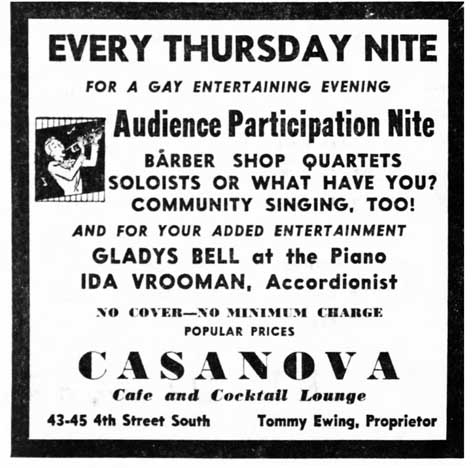
Minneapolis Tribune, January 17, 1949
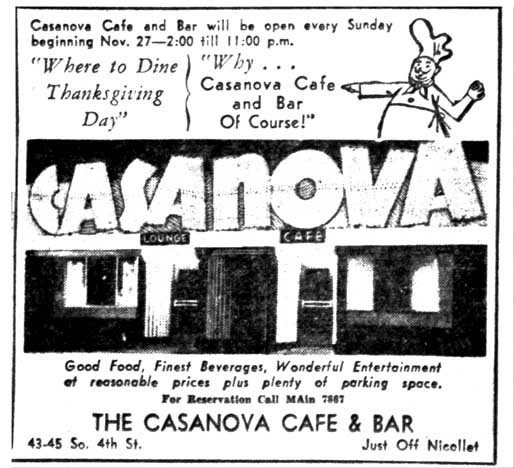
Minneapolis Star, November 23, 1949
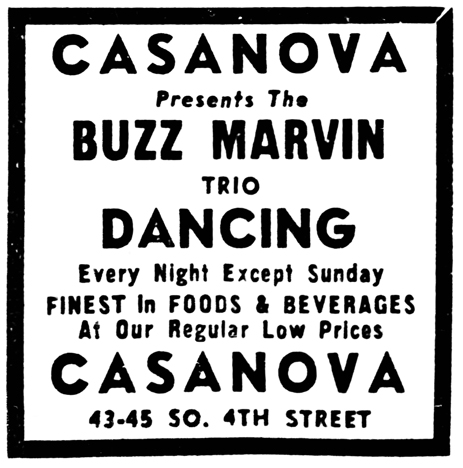
Minneapolis Tribune, November 9, 1950
TOMMY EWING AND THE STREETCAR SCANDAL
In 1952, the City of Minneapolis had been persuaded to tear up its streetcar line and transition to buses. Those having stock in the streetcar company (TCRT) were under suspicion of underhanded dealing, and some went to prison. This is an oversimplified statement and if you want to know more, please read up on it. With Tommy Ewing, the owner of the Casanova, so tight with Tommy Banks, it is not surprising that Ewing owned 1,300 shares of stock in TCRT. (Minneapolis Tribune, January 15, 1952)
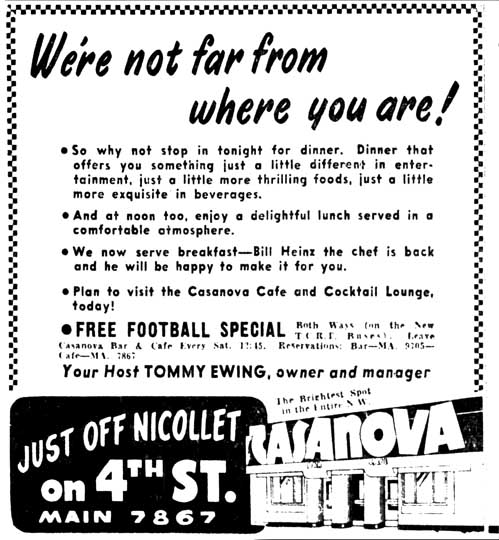
Minneapolis Tribune, September 28, 1952
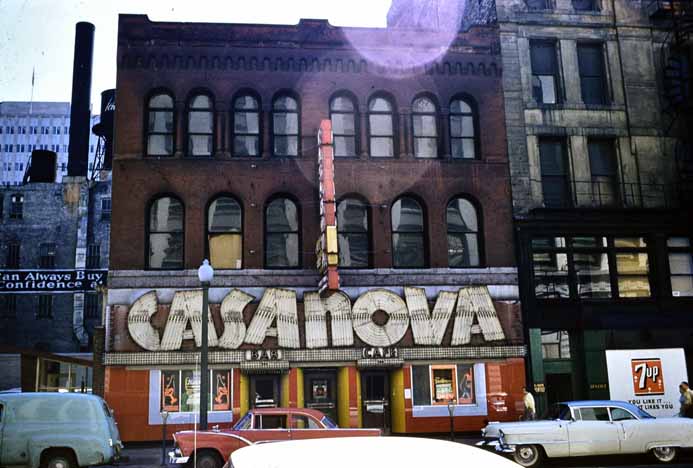
1959 Photo Courtesy Hennepin County Library
THE END OF THE CASANOVA
In the late 1950s, the City of Minneapolis had no interest in preserving places like Newspaper Row and its hodgepodge of 19th Century buildings. Wholesale demolition of problem areas seemed like a good idea at the time, and the Minneapolis Journal Building was slated to go. The City bought the building, and in September 1959, an ad was placed:
RESTAURANT-BAR FIXTURES
Wrecking building, must sell restaurant & bar equipment. 30 booths with formica top, tables, chairs, 2 bars, 4 walk-in coolers & compressors, kitchen equipment. 5-ton air conditioning equipment & many misc. items Open 1 to 5 Mon. thru Thurs, Sept 21-24, Casanova Cafe & Bar. (Minneapolis Star, September 18, 1959)
.
The photo below, taken from Fourth and Nicollet, shows the Casanova in the left-hand corner, looking boarded up.
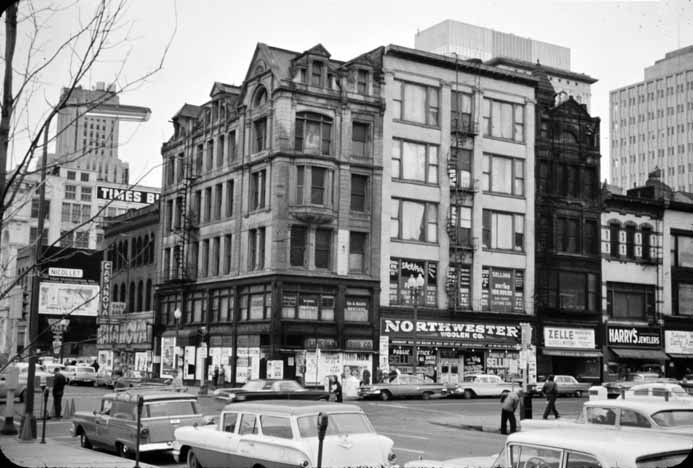
1960 photo courtesy Hennepin County Library
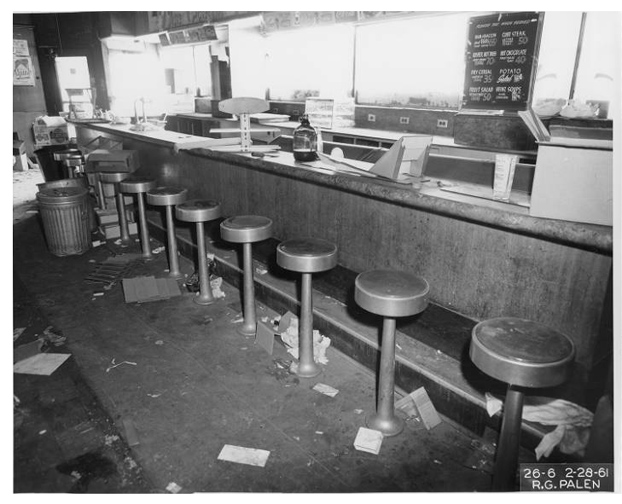
What was left of the Casanova, February 28, 1961. Photo courtesy Hennepin County Library
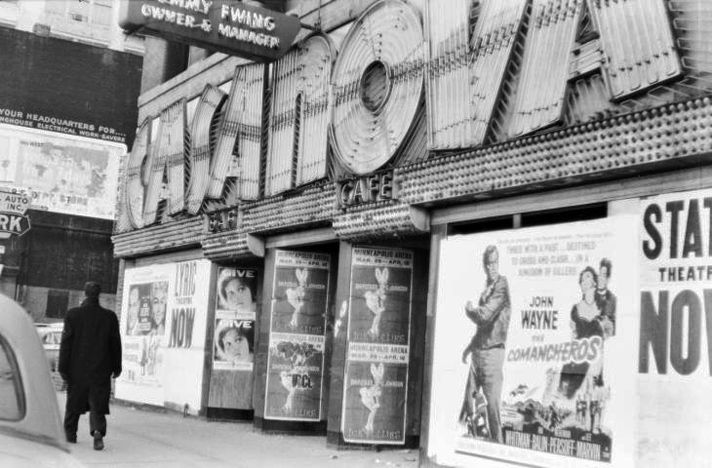
This photo is undated but probably taken at the same time. Hennepin County Library
The demolition permit for this building was taken out on June 11, 1962.
These are some venues located at 829 Hennepin Ave.
- The Gopher Cafe
- Cascade 9
- Zachariah’s
- El-J’s
- Duff’s second location
THE BUILDING
725-735 Hennepin Ave. was built in stages: a 120 x 70 brick store building was erected in 1908 for $10,000. An addition of the same size and approximate cost was built the same year.
THE GOPHER CAFE
Since 1935 this was the location of the Gopher Cafe, named after a previous location near the U of M Campus. (Apparently there were many different Gopher Cafes at the U, but this one was likely at 313-315 14th Ave. SE) It was owned by Jimmy Demos, a Greek immigrant. Classified ads were very specific, requesting Fountain Girls, Attractive Waitresses, Girls, Porters (must be “Colored”) and pastry chefs.
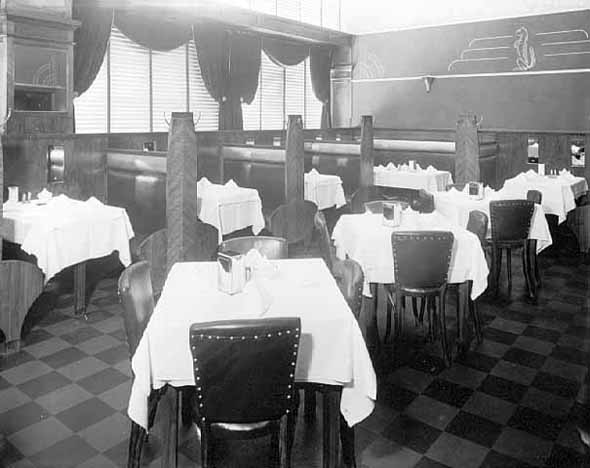
The Gopher Room. 1936 Photo courtesy Minnesota Historical Society
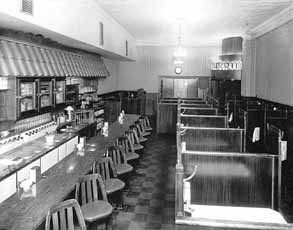
1936 Photo courtesy Minnesota Historical Society
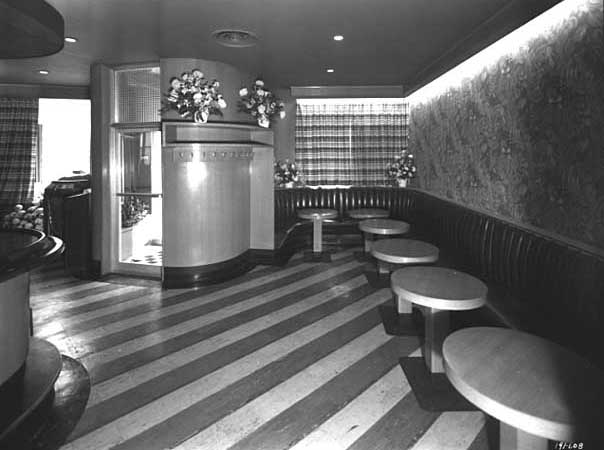
1936 Photo courtesy Minnesota Historical Society
A representative from the contracting firm of Kraus-Anderson posted on Facebook that it did the remodeling work of this downtown landmark, a center of Minneapolis nightlife from the 1930s to the ’60s.
One reason for the Gopher’s centrality was its location: on the corner of 9th and Hennepin, it was in a theater district, the remnants of which can still be seen along Hennepin Avenue. Another thing about the Gopher Café was that it never closed. From 1935 to 1964, the Gopher was open 24 hours a day, seven days a week, with possible exceptions being made for the many renovations and expansions required to keep up with the its role as a mecca for nightclub and theater goers.
In 1950, Demos began to run ads disguised as comics. There was apparently a part of the restaurant called the Minnesota Room.
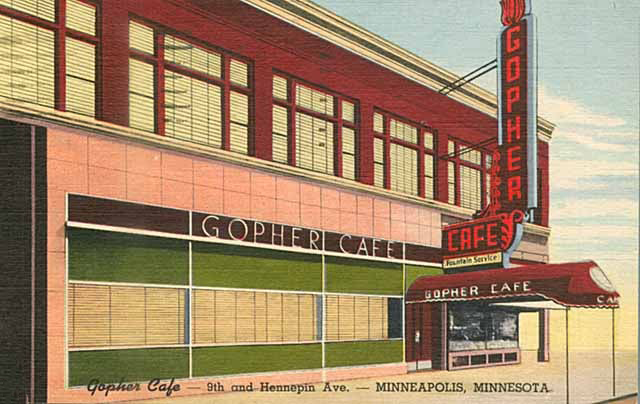
1950 Photo courtesy Minnesota Historical Society
In August 1951, extensive remodeling was done to provide for a cocktail lounge. The permit card showed the cost to be $3,000.
In 1953, Kraus-Anderson did an astounding $10,000 in alterations to the building.
On May 2, 1958, the Gopher Cafe opened under new ownership, again by Greek immigrants. They were George Kosmas and his son-in-law, William Kordaris. Demos remained the owner of the building and remained in charge of the cocktail lounge. The Gopher was located outside the Liquor Patrol Limits.
The stock of the Gopher Cafe went up for sale on September 24, 1964.
1964
CASCADE 9
After two years of redesigning the restaurant, Jimmy Demos reopened it as the Cascade 9 on November 24, 1964.
Where magazine provides an extensive background into the beginnings of the Cascade 9.
One hardly expects to open a restaurant door on Hennepin Ave. and find the re-creation of a Colorado silver mine. But that’s precisely what lies inside the heavy wooden door of the Cascade 9, an intriguing and very atmospheric restaurant. The decor within simulates a series of caverns below the earth and the dim lights, each one made of heavy hand-cut crystal in a combination of greens and ambers, enhance the effect. It is no wonder that the atmosphere seems so authentic, since the research and planning which culminated in the opening of the restaurant took over two years.
The inspiration for the Cascade 9 was the Kelsay Mines, made famous in 1900 by a tremendous mineral find. Seemingly the last word in authenticity is the pickaxe from the Kelsay Mines which bedecks the front entrance at Cascade 9. Authentic memorabilia and souvenirs abound – stalactites, a waterfall, intricate stone work and a piano bar top made from rocks hand-picked on Xanthi, an island in the Mediterranean, and artfully placed so as to allow the passage of light. (January 20, 1968)
Don Morrison’s description of the place was more lighthearted. He called the decor “sort of Contemporary Mineshaft with Lourdes Grotto overtones.”
Set into a couple of the craggy walls are niches trickling water and sprouting ferns. Handrails conducting one between the multi-leveled rooms are made of massive iron chains having five-inch links. A series of such heavy chains hanging from the ceiling provides a screen between two of the rooms. (Minneapolis Star, November 23, 1964)
Rooms included:
An alcove at the Hennepin end contained the piano bar.
The Main cocktail lounge had a long bar, booths and tables.
To the rear is the rear was the room with the “flaming fountain, around the periphery of which are banquettes with Gothic-looking backrests that confer a vaguely ecclesiastical flavor.”
On the other side of the chain screen is the main dining room.
Two other large dining rooms were available for private parties.
So the name Cascade 9 came from the cascading waterfall, and the fact that it was on the corner of 9th Street. Uh huh!
THE MENU
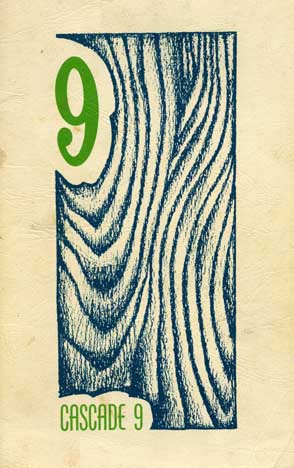
Menu cover image courtesy Scott Smith
A menu generously loaned by Scott Smith has these additional bits of information:
The pickaxe was one of the 76 used during 13 continuous days of hand digging to rescue 43 of the estimated 100 trapped miners and prospectors at the Kelsay cave-in in 1903.
The rocks used in the walls are porous volcanic stone gathered from the 4,000-foot elevation of Mount Jacumba. Souvenirs of the rocks were made available to customers.
The Water and Fire Lounge had a waterfall in the corner which converted to a fireplace in the winter.
Drinks included the “Lamp Lighter,” with secret ingredients served in a candle-shaped glass and a two per person maximum.
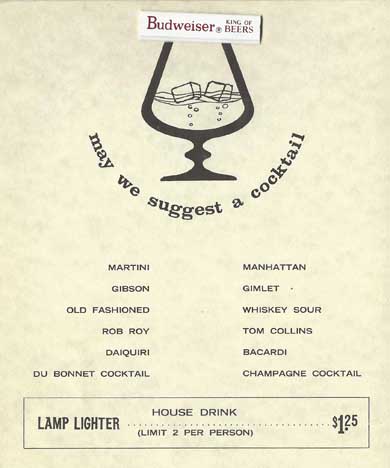
Menu image courtesy Scott Smith
1965
January 1965 saw the first mention of entertainment, which was the piano lounge. The first ad did not mention who was playing the piano.
1966
Jazz musician Chuck Cochran was entertaining at the club in February 1966.
Select magazine began carrying the ad below in about September 1966, calling the place “An Adventure in Dining.” The same ad could be seen into January 1968.
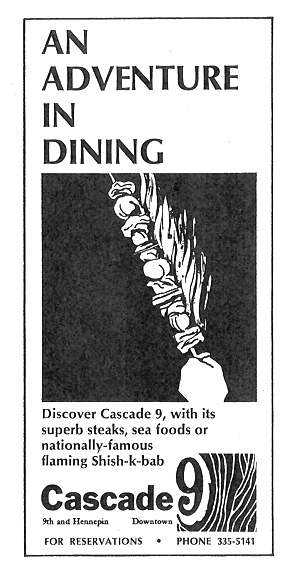
Select magazine
1967
Hugh Cardenas handled piano lounge duty, alternating with “Lorna,” in April and May 1967. The club was also offering a “dinner and a movie” special. Times must have been tough – by May 1967, Lorna was handling the piano bar by herself.
But in August 1967, Dick Clauson was brought on to provide organ music to double your pleasure in the piano bar.
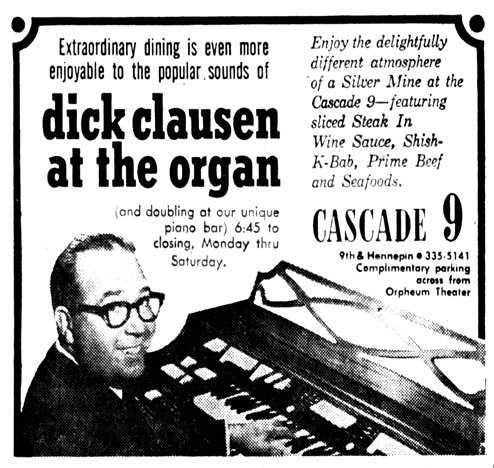
Minneapolis Star, August 23, 1967
1968
On January 1, 1968, entertainment was provided by the Dixielanders, “playing music sweet and hot.” Members included Bob Benum on the drums, Doc Evans on clarinet, Harry Blons on trumpet, and Eddie Tolch on “piano and pipes.” (Where magazine, January 1968)
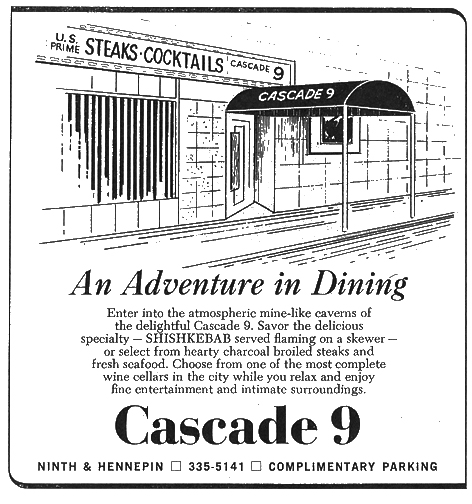
Select magazine ad, November 1968
1969
Frank Cammarata entertained in January 1969.
Harry Blons’ Band opened an engagement in March 1969. Don Morrison reported that a new dance floor and bandstand had been installed. Blons continued through the rest of the year.
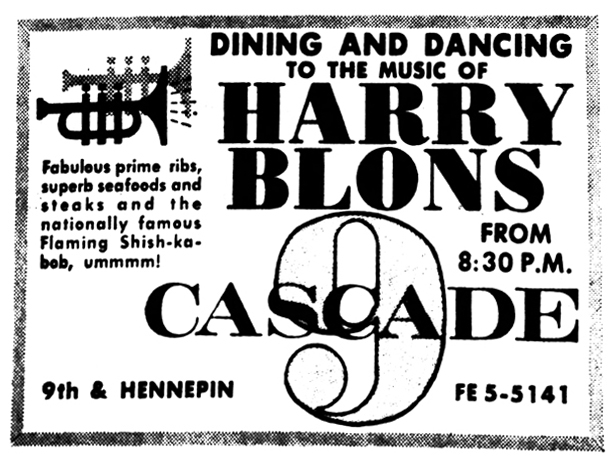
Minneapolis Star, March 21, 1969
Jimmy Demos retired and sold the restaurant in 1969, according to his obituary.
1970
Harry Blons continued his engagement, playing Dixieland until about January.
On February 1, 1970, rock ‘n’ roll took over, with the XL-5.
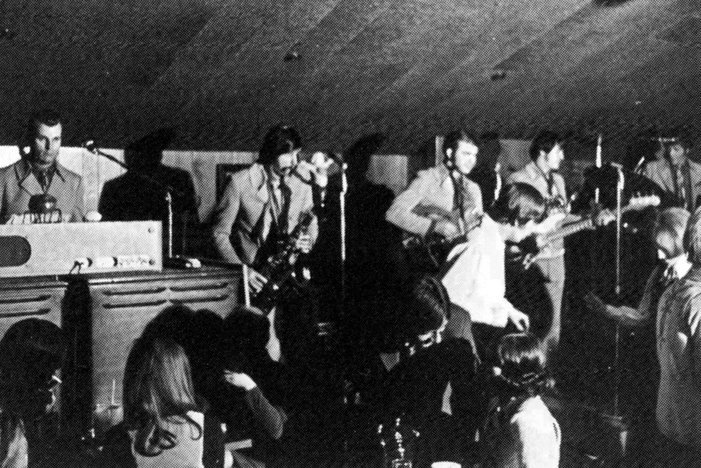
The XL-5. Photo from the Insider, March 21,1970
The photo below is cropped from a larger picture that Mike Evangelist took standing in front of the M.L. Novak Jewler’s building at 930 Hennepin (later National Camera).
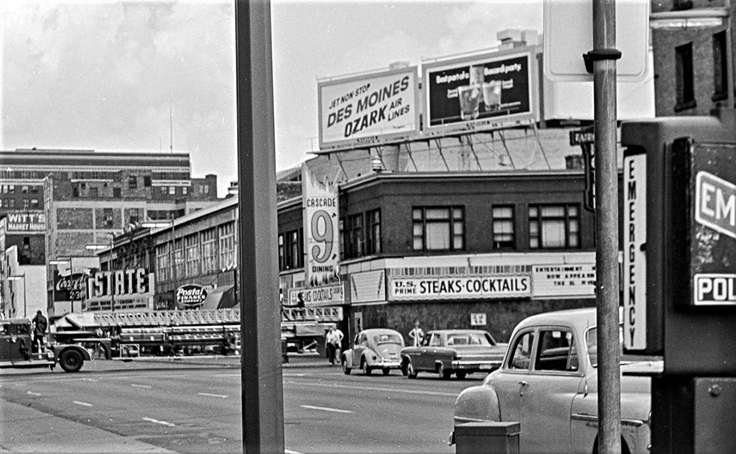
June 1970 photo courtesy Mike Evangelist
1971
The XL-5 finished their year-long run in March 1971.
In August 1971, Don Morrison noted that to accommodate the nighttime crowds, the place has almost doubled in size.
The Del Counts were the house band from 1971 to 1972.
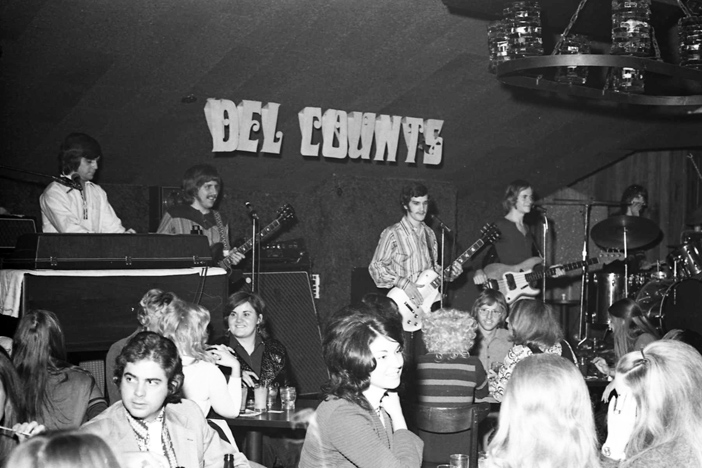
Del Counts, October 11, 1971. Photo copyright Mike Barich.
1972
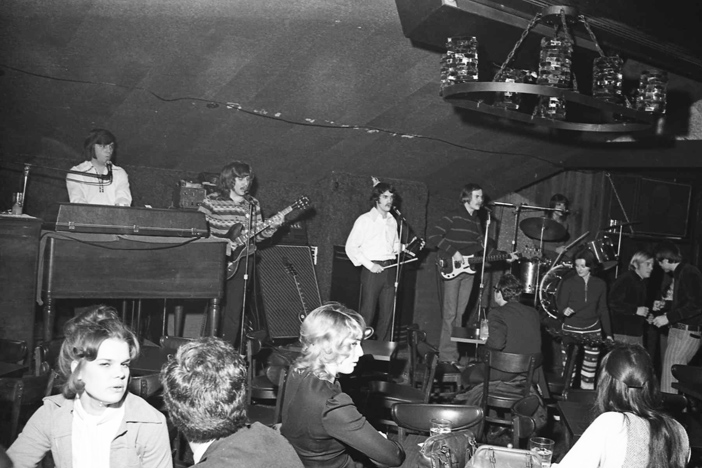
Del Counts, January 13, 1972. Photo copyright Mike Barich.
WAYNE COCHRAN
On March 23, 1972, Wayne Cochran and the 14-piece C.C. Riders appeared at 8 and 10 pm at the Cascade 9.
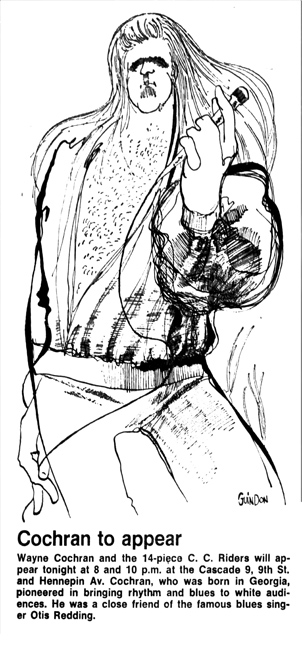
An iconic Dick Guindon sketch in the Minneapolis Tribune, March 23, 1972
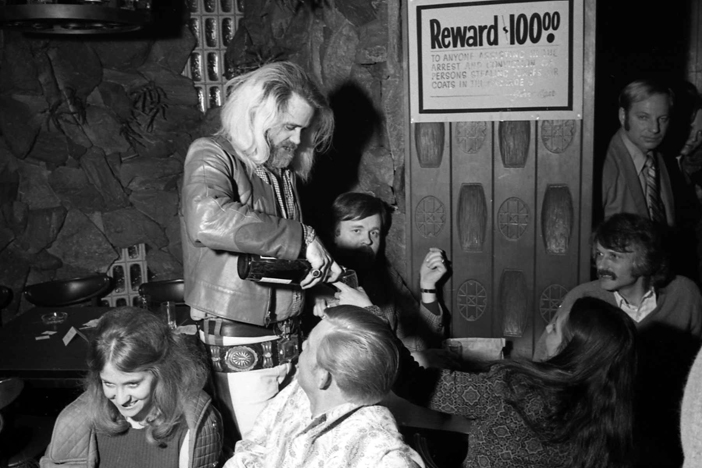
Wayne Cochran, March 23, 1972. Photo copyright Mike Barich
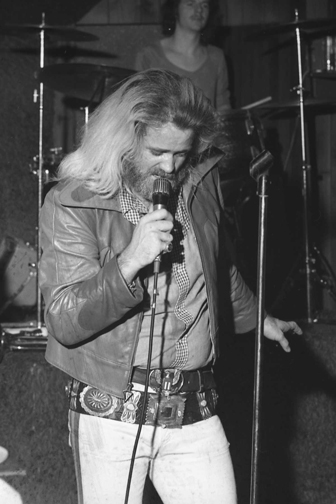
Wayne Cochran, March 23, 1972. Photo copyright Mike Barich
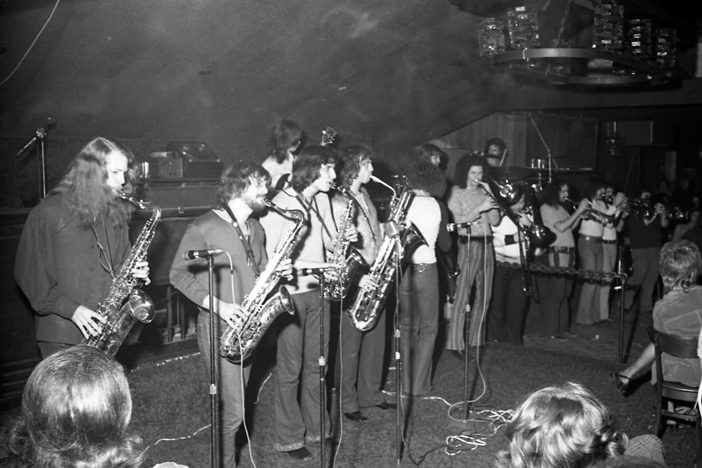
Wayne Cochran’s C.C. Riders, March 23, 1972. Photo copyright Mike Barich
WATERFALL
In 1972, the Cascade 9 published its own monthly magazine, Waterfall. Volume I, Number II was dated July 1972, but there’s no telling how many issues there were. Principals were:
- Editor: John Edmund Sharpe
- Associate Editors: Aubrey Chapin, Rhonda Cupcake
- Art Director: Dane A. Krogman
- Photography: William Keenan, Len Scuvver
- Sports Editor: Larry Bader
- Publisher: Jerry Agar
Although he doesn’t seem to be credited, Mike Barich provided all of the photos of the Rolling Stones concert that was reviewed in the July 1972 issue.
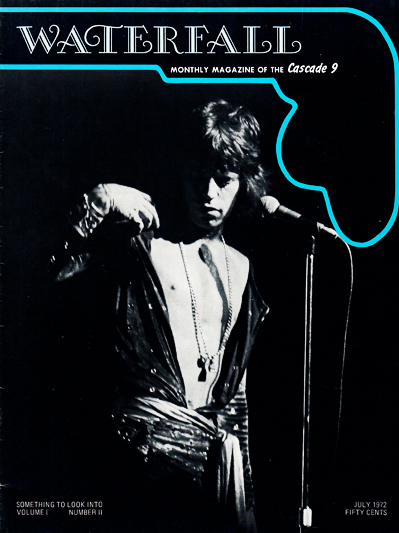
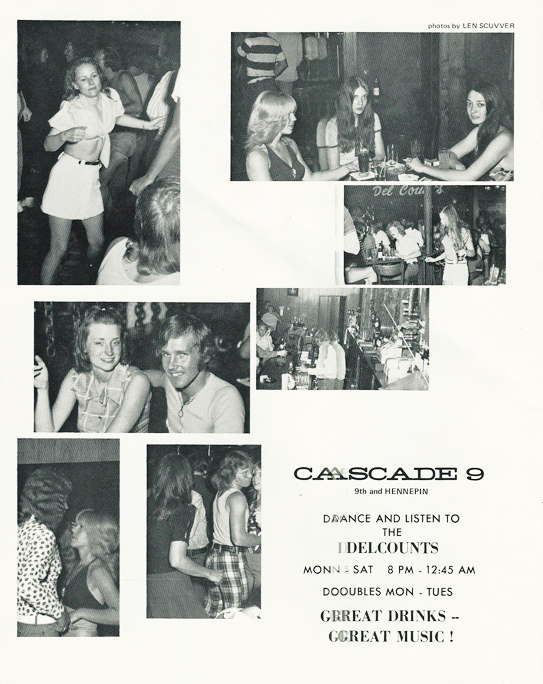
From the July 1972 issue of Waterfall
An article in the Minneapolis Tribune date November 27, 1972, named Jerry Agar as the owner of the Cascade 9.
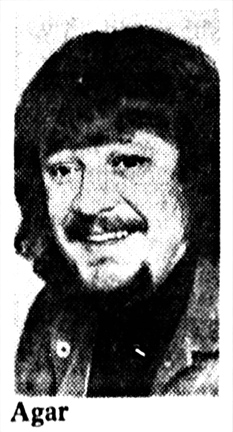
Jerry Agar. Photo from Minneapolis Tribune, November 27, 1972
On December 9, 1972, the Tribune named LaRae Agar as the owner.
1973
In February 1973, owner LaRae Agar plead guilty to failure to withhold Social Security taxes for her employees at the Cascade 9 and another business. (Minneapolis Star, February 2, 1973)
June 1973: Teen King and the Princes
In September 1973, Jerry Agar was identified as the Manager.
1974
A notice was posted in the Minneapolis Star on May 5, 1974, that the Cascade 9 was “Opening Soon,” under the management of Pete Demos. Another gave the re-opening date as October 4, 1974.
1975
ZACHARIAH’S
On November 23, 1975, classifieds started for staff for a new club. From at least April to November 1976, the club was transformed into Zachariah’s, the home of Becky and the Sky Blue Water Boys. Johnny Hanson recalls that his band the Radio Rangers played there for three months, but was fired for demanding to be paid! The club went out of business in November 1977.
1977
EL-J’S
A blurb on November 18, 1977, describes El-J’s as the Former Zachariah’s, and says there’s a house band, but doesn’t say what it was called. The Grand Opening was held on December 13, 1977.
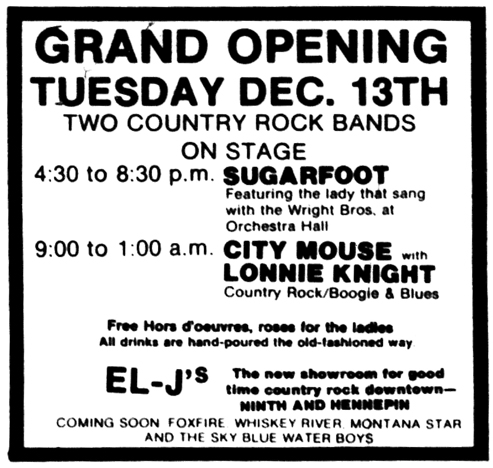
Twin City Reader, 1977
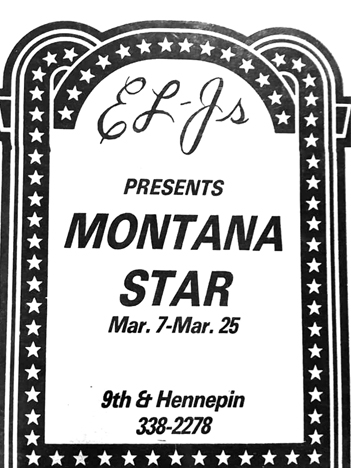
1978 Ad courtesy Sandra Kenyon
DUFF’S
When the original Duff’s burned down at its location at 21 So. 8th Street on December 24, 1978, owner Bob McNamara moved it to 829 Hennepin. He described the building as “a mess” and for six weeks he and 12 of his employees worked to paint and rehab the space in order to open it.
Duff’s opened here on March 1, 1979.
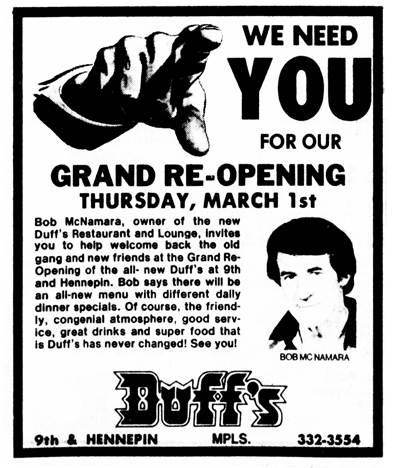
Minneapolis Tribune, 1979
By all accounts, the new Duff’s was a man’s man’s Sports Bar in capital letters. It was also an Irish bar, with a Shamrock on the dance floor.
Owner Bob McNamara instituted several gimmicks, including “Topless Waiter Night,” a “Blitz Bus” shuttling U of M students to and from the bar, and Amateur Bartender and Waitress Night. (Minneapolis Star, November 23, 1979)
When it first opened, Monday was disco night, drawing students. Bands were brought in the rest of the week.
LOCAL ACTS
These are some of the bands I could find in calendars of events:
1979: Wind and Silver, First Flight, Areca, XL-5
1980: Areca, XL-5, Jules, Take Phive
1982: Areca
1984: Jomama, Recessive Traits, Don’t Ask, Super Cats, Showdogs, Go Great Guns, Criminals, Johnny Rey and the Reaction, Tete Noires, the Babysitters.
NATIONAL ACTS
Although I couldn’t find any ads for major concerts, Mike Qualley sent in these tickets showing that there were indeed some national performers:
Shawn Phillips performed at Duff’s on February 28, 1984.
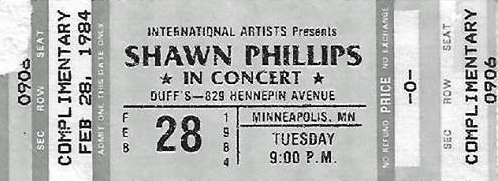
Shawn Phillips ticket courtesy Mike Qualley
Roger McGuinn performed at Duff’s on April 2, 1984.

Roger McGuinn ticket courtesy Mike Qualley
CLOUD 9
In May 1985, classified ads began to appear for staff for Cloud 9, “a progressive, alternative lifestyle bar.” Nothing else pops up until January 31, 1986, when the bar is called the Cloud 9 Express in an article about crime against gay people. Jim Tiggas is identified as the owner of the bar. (Minneapolis Tribune)
In September 1986, the Cloud 9 was in the paper when a German tourist was robbed by a man in drag that he met at the bar. The Tribune made sure to describe the man’s attire as a white, knee-length dress and pink boots. (September 10, 1986)
A notice on August 17, 1987, shows that Cloud 9, Inc. at 829 Hennepin Ave. had declared Chapter 11 bankruptcy on August 7, 1987. James B. Tiggas was the President.
The building was sold in December 1987 and 829 Hennepin is no more. It has been replaced by LaSalle Plaza, 825 Hennepin at 9th Street, built in 1991.
Case Bar was located at Case and Arcade in St. Paul. This was one of the many places owned by the Montpetit family – in this case by Warren Montpetit.
Casey’s Saloon was in St. Paul in 1973, and made the news when it hired a male stripper named Romulus. Owner Glen Triviski felt women should have their fair share. On April 8 the St. Paul City Council ordered the club closed because the go-go-dancers were allegedly performing indecently. A new ordinance was passed allowing dancers to be “covered with transparent or opaque clothing.” Romulus, a/k/a Gary Watkins, was a 23-year-old med student working on a degree at Indiana State University. Although he had been touring the country, he sometimes forgot to unbutton his shirt. “And when that happens, he says, sometimes a button pops off.” (Randy Furst in the Minneapolis Star). ‘Spose there’s a Dr. Romulus out there somewhere?
This theater at 220 Washington Ave So. opened in 1892 and closed by the police in 1895.
This site was located at the Shorewood Plaza Shopping Center, a strip mall on Central Ave. in Fridley.
HULLABALOO TEEN SCENE – FRIDLEY
The first venue here was a Hullabaloo Teen Scene club, which opened here in early March, 1968. (There was another Hullabaloo Club in St. Louis Park.)
Denny Johnson of the Jokers Wild has contracts that show that the band played at a Hullaballoo Club in Minneapolis on March 30 and June 2, 1968. The contracts were signed by Mrs. Merle Kratoska, M & K Teen Clubs, Inc.
Merle’s son Paul: “My brother and I remember my mom driving us around to community colleges and putting fliers under car windshield wipers as advertising for the up coming weekend. It was located just north of Moore Lake in Fridley, just east of Hwy 65. It only lasted a year or two.”
JOKE’S ON THE JOKERS WILD
An “About People” column by Margaret Morris in the Strib dated March 27, 1968, described the Jokers Wild “sitting sheepishly under hair dryers at the Red Carpet” hair salon.
“Usually I wash my own hair,” said the tall, red-haired bearded spokesman in tight navy and white striped dungarees. “We’re just here because she said we had to.”
Dollars to doughnuts that was poor Lonnie Knight under the dryer. Here’s the rest of the article:
“I told them when I booked them that whey would have to do something their hair. It looked unkempt. Long hair is an asset in their business. But their locks needed design. They are not what you expect – not sissies. One attended Dunwoody Institute to learn construction of musical instruments and how to repair them. They are dedicated musicians.”
“Don’t cut, it will bleed,” protested the youngest man in the combo as Gordon Lockley, owner of the hair salon, took up scissors. Lockley waggled his arms and snipped away. “What’s that stuff?” the youth asked sniffing a cloud of hair spray.
Mrs. Lloyd B. Thompson came in for her regular shampoo and set and looked aghast at the infiltrators. She walked to the back of the salon muttering, “Is this a happening?”
“They are real fine boys,” said Mrs. Kratoska. “I got to know them when they rented the Hullabaloo to practice. They came at noon and would forget to eat. Sometimes, they’d stay until 2:30 in the morning when the booking agent chased them out. There are hundreds of bands in the area, but these boys are going into the big time.”
When and if they do, it will be with shimmering hair styles by Locksley – at $17 a styling.
The Fridley Hullabaloo indeed didn’t last long, and the location opened as the Casino Royale on October 18, 1968.
CASINO ROYALE
Hullabaloo was followed by the Casino Royale, which was opened by John and Annette Flaherty on October 18, 1968. The Flahertys had owned Someplace Else in Robbinsdale.
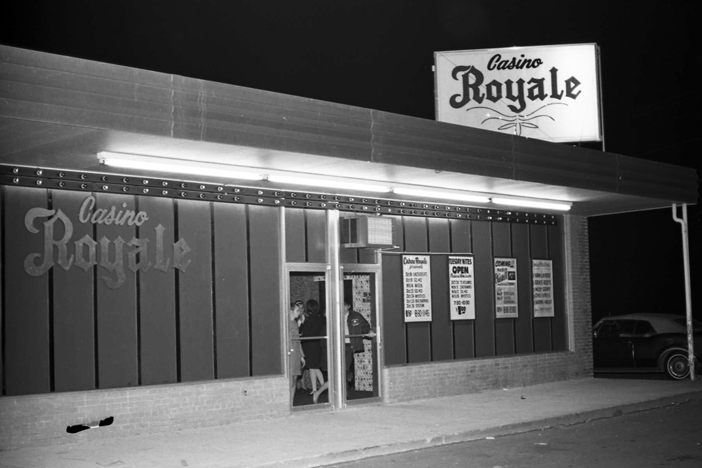
October 25, 1968. Image copyright Mike Barich, St. Paul
On December 8, 1968, the Minneapolis Tribune Sunday Picture Edition did a huge spread on the club, written and photographed by Mike Zerby.
Snippets:
- The Manager and booker was Bruce Brantseg, age 24, who worked for David Anthony.
- There were two sections: a ballroom, with tables on the sides, and the bar, serving pop for 15 cents.
- It opened on October 18, 1968.
- There were two cops and a bouncer. Sign: $100 fine for anyone involved in any fight or disturbance.”
- Bands playing there included the Litter, Good Idea, Marauders, Classic IV, Mystics.
- Decorated in a casino theme, with large cards, dice shakers, and roulette wheels painted on walls.
- Pinball and snooker tables.
- Restricted to ages 16 to 20; sign says “Be 16 or be Gone.” (Annette Flaherty said that parents were welcome for free.)
- “No coats or jackets allowed inside – free coat and purse checking here”
- Zerby: “The faces of the teen-agers were unsmiling and, seemingly, uninvolved. One explained, simply, that one stayed “cool.”
- Open Tuesday nights from 7:30 to 10:30 and weekends from 8:30 to 11:45. “Three hours is long enough”: Brantseg.
- Zerby: “At the end, the teen-agers seemed pooped, but somehow restored. It was as if they had undergone their own version of entertainment mixed with shock therapy.”
Entertainment was probably exclusively by local bands.
The C.A. Quintet performed there several times in 1969:
- July 11
- July 18
- August 25
- September 18
- November 28
Pepper Fog performed on November 8, 1969.
The Flahertys sold the club to Carl Rostburg.
By 1970 it was a Country place, owned by Lee Silverton. In April 1970, Texas Bill Strength was working there Fridays, Saturdays, and Sundays.
ANTHONY B. CASSIUS
To talk about the Cassius Bar is to talk about Anthony Brutus Cassius, so we’ll start with his impressive resume. Much of the information below comes from:
- A long article in the Minneapolis Star Tribune published on August 14, 1983, on the occasion of his passing
- An article dated December 8, 1939, in the Minneapolis Spokesman
- Census data from Ancestry.com
A warning that some of these dates don’t match up, which happens when they come from different sources and different memories.
A.B. Cassius was the son of southern slaves; his father was a minister who had run away from a plantation. Census data shows that his father was born in Virginia and his mother was born in Texas.
Anthony was born on June 29, 1907, in Guthrie, Oklahoma.
In 1920, Anthony left his family in Guthrie, Oklahoma at age 13, leaving behind 22 other brothers and sisters. He made his way to St. Paul with $7 in his pocket.
He found work at a hotel and slept on a mattress in its basement while he attended Mechanic Arts High School in St. Paul. He went on to attend Macalester College, where he was a star football player, and the University of Minnesota; he reported to the Census in 1940 that he completed one year of college. The Star Tribune reported that at the U of M, he decided to open a restaurant where blacks would be served on an equal footing with whites.
In 1930 he was a waiter in a hotel restaurant, presumably the Curtis, where he served his apprenticeship.
The Strib reported that in 1936 he left the Curtis to run a series of beer parlors and restaurants, including Dreamland.
In 1939 The Spokesman reported that he had been:
- Business agent and president of Waiters’ Union No 614, A.F. of L.
- A member of the Central Labor Union
- A joint executive board member of the Hotel and Restaurant Workers’ Union
- A member of the Urban League Board
- A member of the Masonic Lodge
- He conducted the Urban League Waiters’ School for two years
DREAMLAND CAFE
In 1939, with partner Thel Collins, he started the Dreamland Cafe. Dreamland did not have a liquor license, but was a fancy, dress-up establishment in the center of the city’s south side black community where everyone felt comfortable.
In 1940, when he registered for the draft for World War II, he reported that he was a waiter at the Curtis Hotel.
CASSISUS BAR AND CAFE
In 1946 he sold Dreamland to buy his own bar with a hard liquor license. He aspired to become the first black man to own a hard liquor license in Minneapolis, but the City Council put one obstacle after another in his way. One argument was that he was still the owner of Dreamland, which he wasn’t. Another was that he was a Communist, because he was friends with the head of the Communist Part in Minneapolis. (Being a strong Union man didn’t help this cause either.) One Alderman even had the nerve to say that black people should only be licensed for “barbeques, shoeshine parlors, and barbershops.”
Finally, after two years and spending all of his savings of $3,500, Cassius got the license, but it left him with no money to set up the bar. He went to Midland Bank and said that he wanted a loan of $10,000. The Vice Presidents laughed and said the only black man they’d ever loaned money to was Cecil Newman, editor of the Minneapolis Spokesman, and that was only $500. But Cassius was persistent and spoke to the Bank President, Arnulf Ueland, and within 15 minutes he had him convinced to give him the whole amount. The note was for 24 months but he paid it off in a year.
207 SOUTH THIRD STREET
The Cassius Bar opened in 1946 in its original location at 207 So. Third Street in Minneapolis. The Strib described it as a “tough, black-run bar” that he overhauled in interior and reputation, and turned into a hangout for sports figures, performers, and politicians.
The Bamboo Room opened in September 1949. It was a jazz venue, featuring such local mainstays as Percy Hughes, Irv Williams, Oscar Frazier and the Four Notes, and the Rook Ganz Orchestra. Prince Rogers and his Combo performed there on Friday and Saturday nights in 1951.
It apparently went dark summers, as it had re-openings in September 1950 – ’53.
The Bamboo Room featured Oscar Frazier in 1954.
The extraordinary photo below is identified as “Cassius Bar and Playroom” and was taken by John F. Glanton. It is probably the original location.
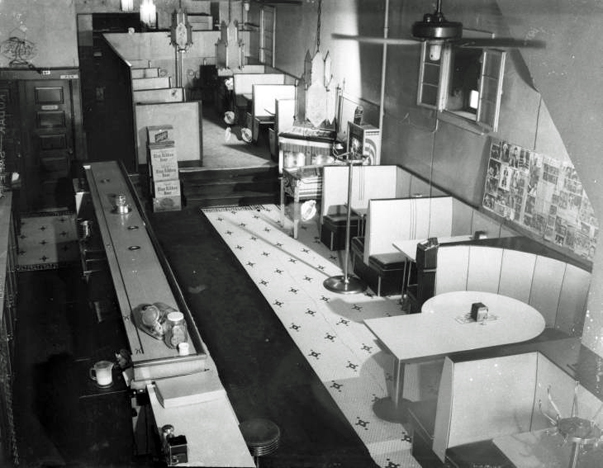
Photo courtesy Hennepin County Library and the children of John Glanton
318 SOUTH THIRD STREET
In July 1958 the bar was moved to 318 So. Third St. in Minneapolis due to redevelopment of the original area. The building, built in 1908, had two stories.
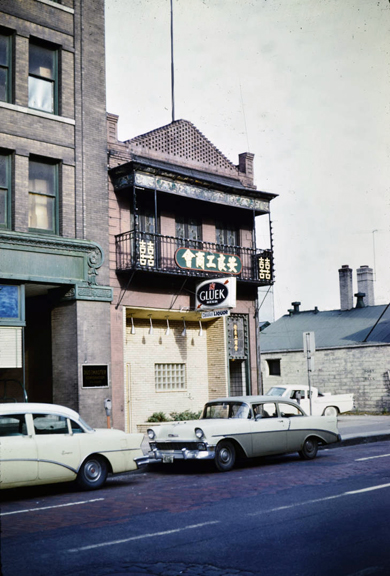
Photo by Dept. of Community Planning and Economic Development, courtesy Hennepin County Library
Kevin Diaz of the Star Tribune article described it:
In its early history, Cassius’ bar was known as a place where whites and blacks mingled in elegant surroundings, dressed in tuxedos and cocktail dresses. In its later history, headlines told of fights, shootings and one well-known police brutality case: A black police lieutenant, Ray Presley, publicly accused two off-duty white colleagues of drunkenness when they arrested a black patron there.
In the 1960s it was the site “Rhythm ‘n’ Blues Time,” a simulcast on KUXL featuring the best in R&B as played by Prime Minister Billy G.
In 1968 Cassius tried to relocate the bar to 401 E. Lake Street, which was outside of the City’s liquor patrol limits. That required a referendum among local residents, which he lost.
On June 20, 1980, the Cassius Bar closed for good. The area had declined for several years, and drugs, violence, and racial turmoil had taken over.
Anthony B. Cassius died on August 1, 1983.
McCREADY’S PUB
McCready’s was run by Pat Mus from about 1980 to 1986, and then sold it to Doc Holiday, who owned it to the end. The manager was Diane Schmidt, who said she had been working hard to “turn the place around.” She said that “It’s been a kind of ‘Cheers’-type place in the neighborhood. It attracts bankers, lawyers, blue-collar types…”
The building burned to the ground on Monday, October 14, 1991.
THE CHINESE GAMBLING DEN
On the second floor of 318 So. Third Street there was a hangout for the elders of the On Leong (Chinese) Merchants Association, accused by the FBI of a big-time gambling operation.
In 1980, five members of a Chinese street gang called the Ghost Shadows held up 150 guest at a Chinese New Year’s party on the second floor, ordering them to undress and hand over their valuables. Retired restaurateur Hugh Wong, working security for the On Leong, which owned the building, shot several of the robbers, who were captured by the police. Wong himself was shot to death four years later, and his killer has not been found. U.S. Marshals confiscated the building from the On Leong in 1990 as part of a national multi-million dollar gambling crackdown against many of the organization’s leaders, including Bloomington’s David Fong. (Minneapolis Star Tribune, October 15, 1991)
This most fascinating venue had two addressess (6 West Channel Street and 215 So. Wabasha in St. Paul ) and several iterations through the years.
SAND AND MUSHROOMS
Approximately 50 caves were created in the bluffs above the Mississippi River in St. Paul in 1840 by the mining of silica sand for glass making. In 1899, French immigrant Albert Mouchnotte found that constant temperature of 48 degrees was ideal for mushrooms to flourish, and started growing mushrooms in seven of the caves. Mouchnotte sold the mushrooms, first to the finest restaurants in St. Paul, and then around the world. During the early 1900s the bluffs became known as Mushroom Valley. Other caves were used for cheese making and beer brewing.
SPEAKEASIES
In the 1920s, the main cave became a series of speakeasies, the first of which was known simply as the Wabasha Street Speakeasy, complete with its own whisky still.
MYSTIC CAVERNS
Ezra Gray explains:
Before Castle Royal there was Mystic Caverns. For a minute, anyway. The fascinating, mostly forgotten story of the brothers Foster, who opened a nightclub like no other inside one of the old glass mines in the East Side river bluffs.
Local gangsters quickly pushed their way in, installing card tables and a roulette wheel in the back. “Floating Flo,” performing a nude(ish) dance à la Sally Rand, appeared briefly on their band stage in the autumn of 1933, creating – not a scandal, really – a local story of interest.
Sadly, the enterprise was ill-fated and short-lived. The brothers somehow ran afoul of local law enforcement’s “night club protective association.” They were out of business by the end of 1934.
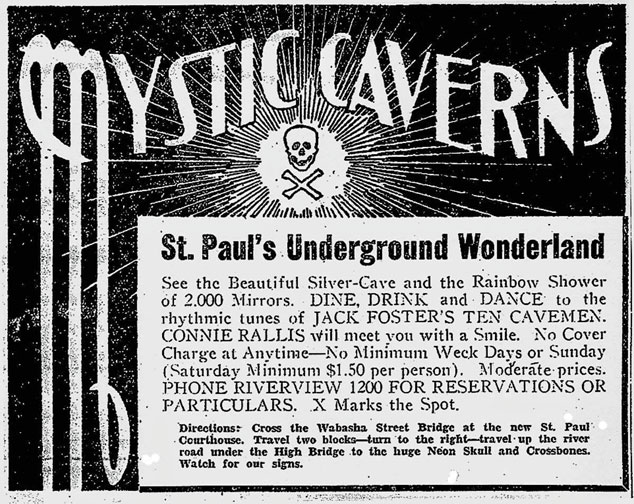
Courtesy Ezra Gray
Mystic Caverns were featured in the September 1933 (?) issue of Modern Mechanix and Inventions, shared on Facebook by Ezra Gray. Caption for the photos below:
- Interior view of the Mystic Caverns of St. Paul, where revelers disport themselves beneath 150 feet of sold sand rock, in a temperature of 48 degrees plus 8 degrees of artificial heat.
- Left: The entrance to the subterranean chamber – a huge gorilla mouth at the base of a towering sandstone cliff bordering the Mississippi River.
- Right: The Bar, a favorite rendezvous.
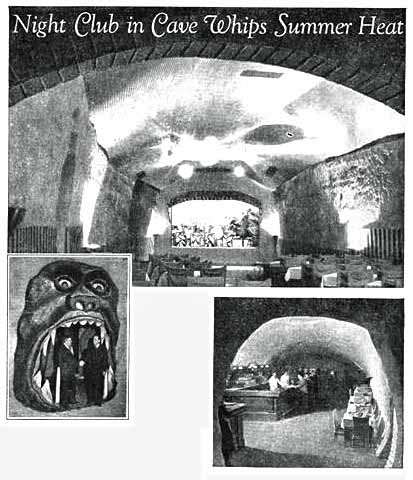
The text of the feature above reads:
St. Paul, Minnesota, boasts a new night club said to be without equal anywhere in the world for novelty and comfort during torrid summer months. Called the “Mystic Caverns,” the club occupies a labyrinth of caves which form a natural refrigerator with a year round temperature of 48 degrees.
The subterranean chambers where the revelers disport themselves have their opening in the face of a towering sandstone cliff bordering the Mississippi. Once you step inside you are literally in the bowels of the earth, with solid sandstone walls all around you and 150 feet of solid sandrock overhead.
About eight degrees of heat make the atmosphere decidedly comfortable inside the caverns when the mercury is flirting with the hundred mark outdoors. In winter, 20 degrees of furnace heat convert the labyrinthe chambers into a cozy beer hall.
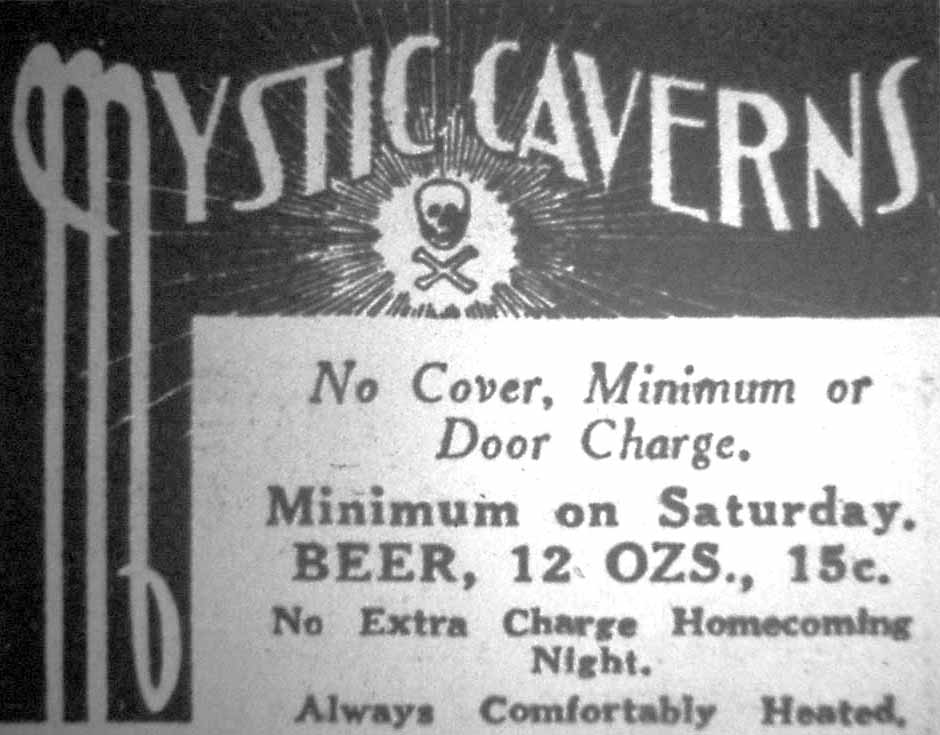
Ad from St. Paul Dispatch, courtesy Ezra Gray
CASTLE ROYAL
From the Lehmann Farms website:
Eventually, Albert Mouchnotte’s daughter Josie and her husband William Lehmann took over the mushroom business. In 1932, they began to convert the main cave into a nightclub. It opened just as Prohibition ended, [October 26, 1933] as the Castle Royal. The club received the first post-Prohibition liquor license in St. Paul. Musicians such as Cab Calloway, Dorsey brothers and Henry James played at the nightclub. Craps and poker took place in the back rooms.
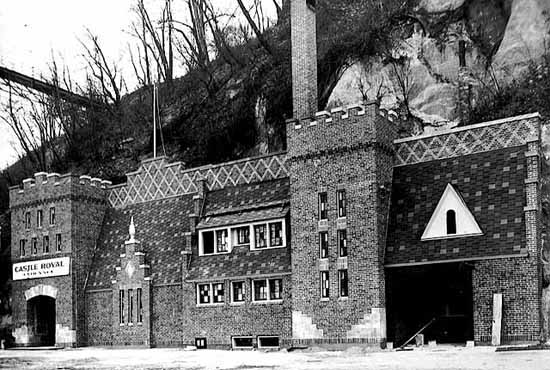
1933 photo courtesy Minnesota Historical Society
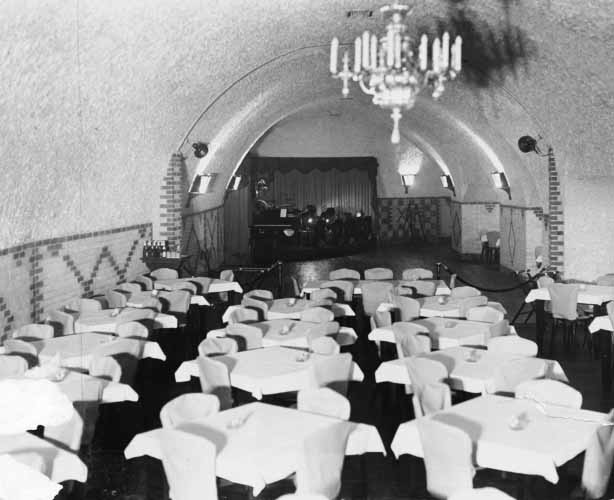
1933 Photo courtesy Minnesota Historical Society
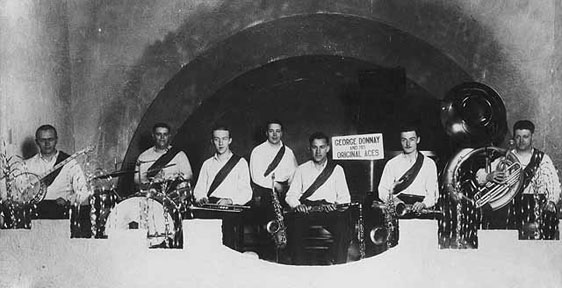
George Donnay and His Original Aces at Castle Royal, 1935. Photo from Minnesota Historical Society
Lehmann Farms website:
Castle Royal was reputedly a favorite of gangsters. St. Paul police chief John O’Connor allowed some of the FBI’s most-wanted criminals to use his city as a sanctuary as long as they didn’t commit crimes in St.Paul. Gangsters such as Ma Barker, Baby Face Nelson, and John Dillinger used St. Paul as a haven, reportedly spending some time at the Castle Royal. Legend has it that there was a 1934 triple-murder in the caves involving Chicago gangsters (the bodies were never found).
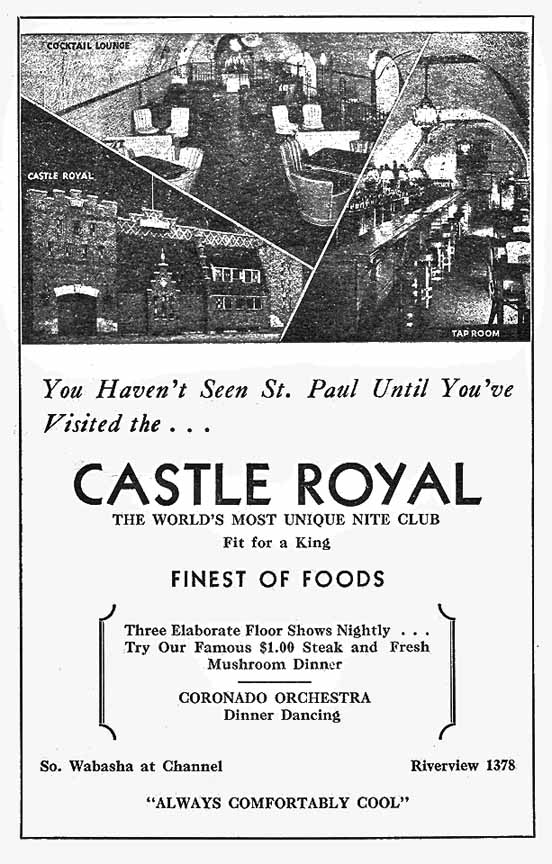
1936 ad from the Hendricks School Golden Jubilee Program
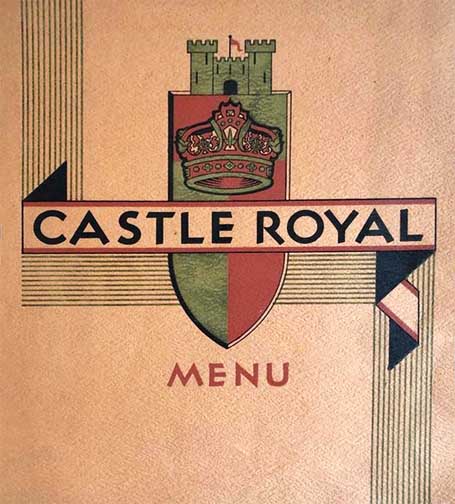
Menu image courtesy Marilyn Ashley Juhl
AFTER CASTLE ROYAL
Lehmann website:
From 1941 to 1965 the caves again became the focus of the family mushroom business. The business ran under a few different names during the time including, “Lehmann’s Hot House” and the “Wm. F. Mushroom Company.” In 1965 William Lehmann sold the caves and moved the business to Lake Elmo where he constructed above-ground sheds to grow the mushrooms.
What happened next is difficult to pin down, probably because there is a series of caves. Here are various accounts, in no particular order:
- The caves were renovated in 1972.
- A disco called the Castle Royal 2 opened in the ’70s.
- Fires were started by the homeless.
- There were “a few failed business attempts.”
- There was a huge flood, which wiped out the housing along the river.
- (Two of) the caves were taken by the city and were filled with flood debris.
- The caves went into bankruptcy and were owned by a bank.
- The bank was about to tear down the outside façade when the caves were purchased with the goal to restore the caves to their former glory.
WABASHA STREET CAVES
Now called Wabasha Street Caves, the venue offers tours and dances, and can be rented for events. The venue’s 12,000 square feet is finished with brick walls, stucco ceilings, carpeted dining space, a hardwood dance floor, a theatrical stage, and a 60 foot bar. Geothermal energy is used to limit fuel need for heating and eliminate the need for air conditioning. See http://www.wabashastreetcaves.com/
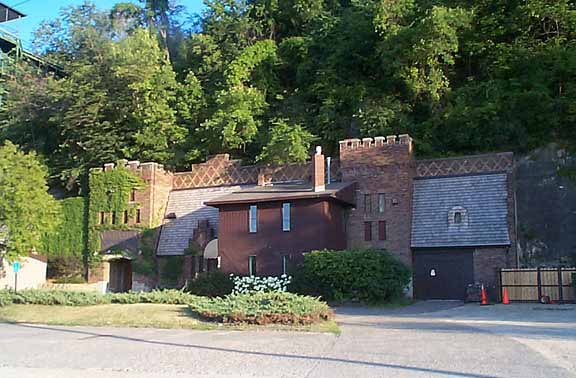
2001 Image via Placeography.org
Save
Save
Save
Save
Save
Save
Save
Save
Save
Save
The Catacombs Coffeehouse was a rather short-lived performance space (at least under that name) that existed in November and December of 1970. Listings in the Strib note a play or two, individual singers, and on November 13, 1970, a rock band called Bacchalia.
It turns out that the Catacombs shared the same address as the Gethsemane Episcopal Church, at 905 So. 4th Ave. in Minneapolis. The church is looking into its records to see if there is any more light to shed on this. Any memories of performing or watching a performance here are welcome! Please contact me!
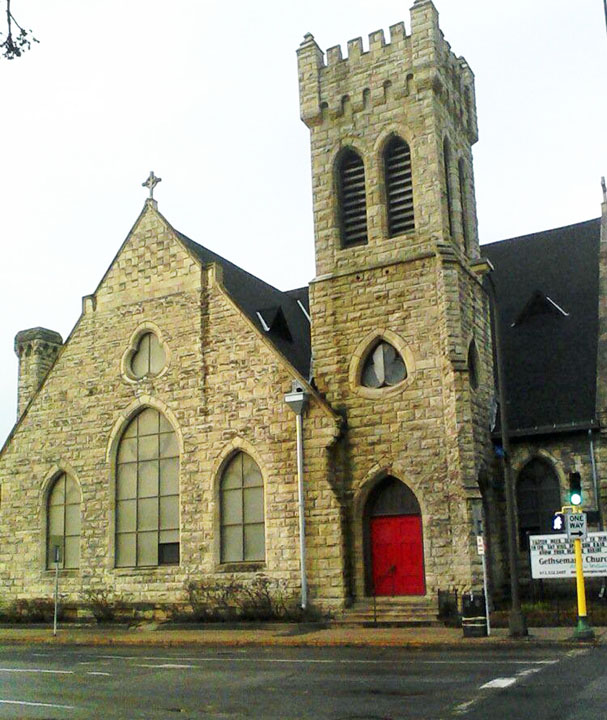
Photo from the church’s website
The CC Tap was at 2600 Lyndale Ave. So. in Minneapolis.
ANCIENT HISTORY
Permit cards show that the building was built in 1884 as “stores and flats” at a cost of $12,000. In 1895 a dressmaker advertised at this address.
By 1900 it was the location of Waldron & Co. Grocers; Henry Waldron was arrested in a crackdown of grocers selling unlabeled baking powder at his store.
By May 1925 the grocery store was the Consumers Groceries Wholesale Supply Co. (a chain with many stores in Minneapolis and St. Paul)
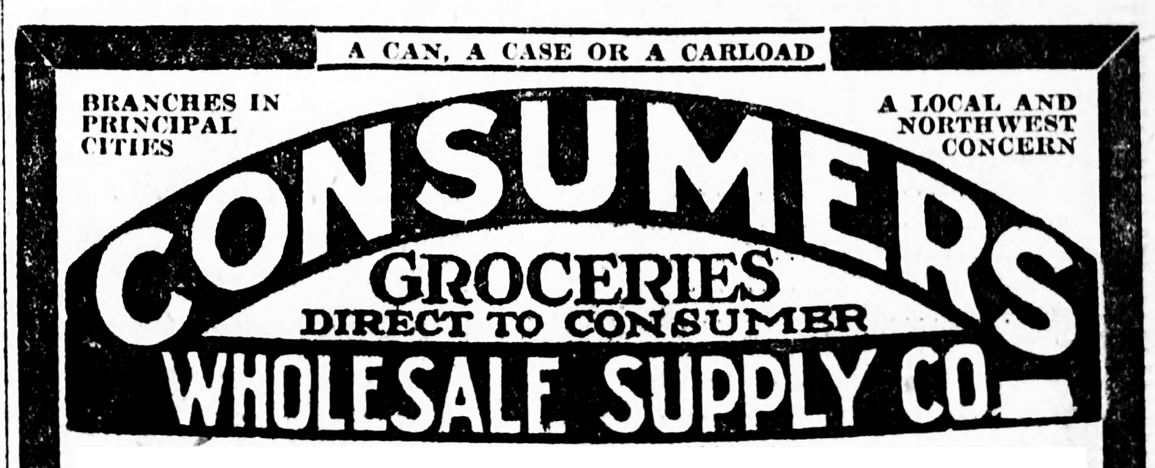
Minneapolis Daily Star, October 22, 1926
National Tea purchased 11 Consumers Groceries stores, including the one at 2600 Lyndale. The announcement was made in the Minneapolis Tribune on November 12, 1927. It was a National Tea in January 1928.
By June 1928, A. Rudoy had a grocery permit, and was probably running the independent Daylight Market, which we see advertised from December 1928 to at least 1930.
From at least May 1933 to May 1934 it was part of the huge Red Owl chain of grocery stores.
CC TAVERN
The beginnings of the CC Tavern seem to be in April 1935, when E.C. Hall received a license to run a “confectionary.” In July 1935, Clarence Campbell received his 3.2 beer license and the CC Tavern was off and running. Campbell was also a real estate agent.
The tavern was advertised for sale in July 1942.
In August 1949, manager Frank Kuffel was fined $100 for violating the pinball ordinance by awarding free beer and cigars for chips earned on the machines instead of free plays. Kuffel was manager from at least July 1948 until at least January 1955. When he died in 1964 at age 74, he was described as a retired truck driver.
Permit records show an extensive remodel in August 1955.
CC TAP
The name changed to the CC Tap sometime between October 1956 and April 1957, according to wantads for staff. The name kind of went back and forth for a long time, though.
In March 1959 the owner was identified as Raymond Abel. In August 1952, a Raymond Abel was the proprietor of Ray’s Sixth Avenue Tavern, at 813 Portland Ave. in Minneapolis.
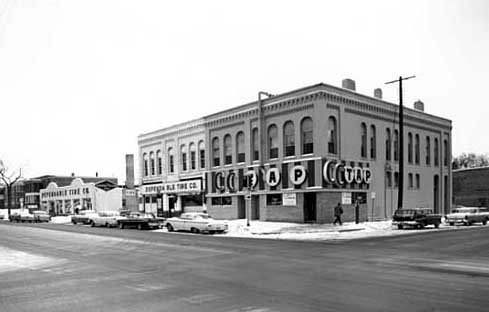
December 28, 1961 photo courtesy Minnesota Historical Society
Abel retired in 1966 because of arthritis according to an article about how he grew mass quantities of tomatoes and gave them to senior citizens in a highrise (Minneapolis Tribune, October 22, 1977) Abel died in 1982 at the age of 64.
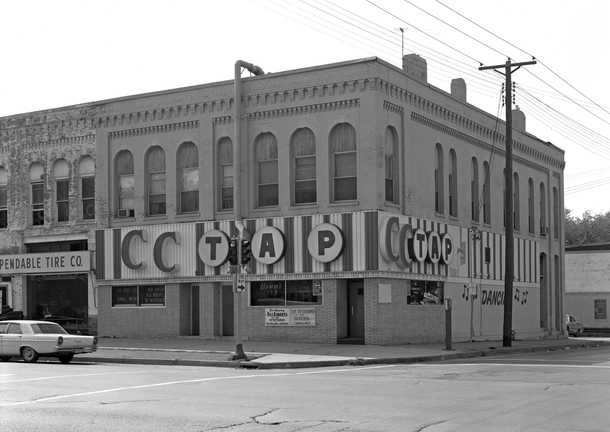
CC Tap in 1967. Photo courtesy Minnesota Historical Society
The bar was remodeled in June 1968.
In 1969 bands included the Vacant Lot and Matinee.
$4,000 in remodeling was done in 1970.
Another $4,000 in repairs were done in January 1972 after a fire.
In March 1972 it was listed for sale.
In July 1974, the owner was listed as Richard Skilbeck, who was seeking a liquor license for the otherwise 3.2 bar.
CC CLUB
On May 30, 1975, a notice included a lot of information:
- The CC Tap was now the CC Club
- It was closed for remodeling and would reopen soon
- It was for sale
- There were four apartments on the upper floor
- A liquor license application was pending
A liquor license was approved in 1975 with the promise that the CC Club would install a kitchen.
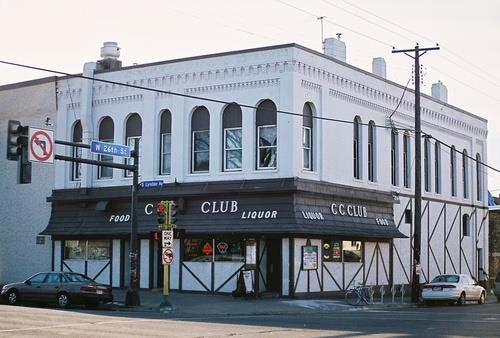
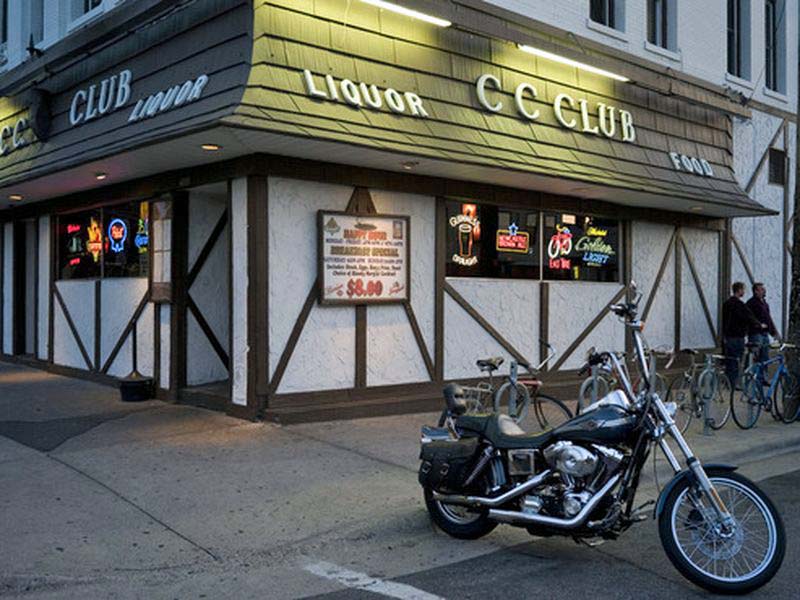
This venue was located at 416 Cedar Ave. So. on the West Bank in Minneapolis.
THE CEDAR THEATER
The Cedar Theater opened on October 28, 1948, as a movie theater, showing the film “Big City,”directed by Norman Taurog. (There had apparently been another Cedar Theater in the 1920s at 713 Cedar Ave.) The Cedar Theater at 416 Cedar Ave. was built by Nathan Shapiro and showman Ben Berger. Nate Shapiro had previously owned Curly’s Night Club. The new theater was constructed by Sebco Inc., a firm that specialized in theaters and night clubs.
Will Jones reported that “a couple of dingy shops and walk-up apartments were torn down to make room for the movie house.” Living quarters were found for people who were forced to move. It was the first theater in the area in 13 years. Berger, president of the North Central Allied Independent Theater Owners Association, had initially blocked Shapiro from getting his license, but after protests from the neighborhood, including children from the Pillsbury Settlement House, he relented and became a partner. (Minneapolis Tribune, October 28, 1948)
The initial announcement said that the theater held 820 patrons, with restrooms in the basement.
Front walls are completely draped, there being no proscenium arch, and decorated with modernistic facial figures before the drapes. The ceiling is blue-green, walls tan and white striped, the foyer decorated in brick and plaster. A heavy-duty air conditioning system has been installed, as well as completely modern projection equipment … The front attraction board is reached from the top of the canopy, obviating the use of ladders in changing the board. (Minneapolis Star, October 25, 1948)
A contest was held to name the theater, with suggestions like
- The Humphrey
- The Stassen
- Snoose Gardens
- The Casbah
But more than 500 people suggested the Cedar, and the Cedar it was. The Southside Businessman’s Association provided a $250 prize to Mrs. R.E. Mellen for submitting the best reason for the name.
Jones also noted that the seats were varying widths, in order to stagger the aisles and provide unobstructed views.
The marquee was constructed by the Naegele Co. for $1,500.
PORN AND UNDERGROUND
It appears that was in about September 1964, that the theater began showing adult movies. Admission for a sizzling double feature was only $1!
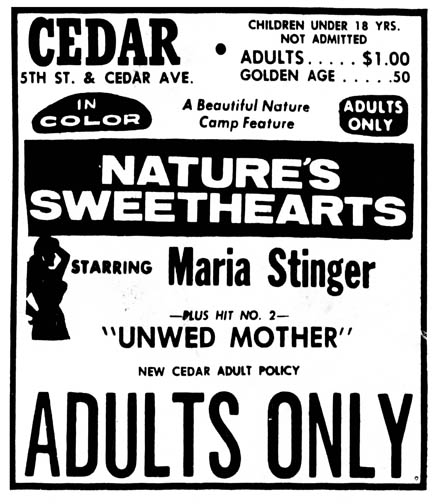
Minneapolis Star, September 17, 1964
On October 1, 1967 the theater began advertising “Underground” films, which were still Adults Only.
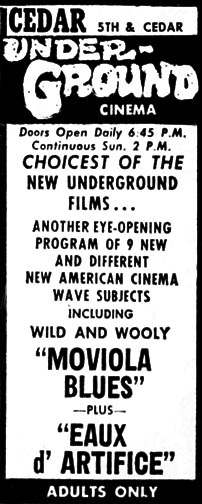
Minneapolis Tribune, November 16, 1967
In January 1968, they showed a “Giant ‘Hippie’ Festival Devoted to the Life and Loves of Hippies!”
In March 1968 they presented an Andy Warhol Film Festival.
But on June 13, 1968, the theater announced that it was coming up from the Underground for the summer and went back on the porn train, showing those classic films, “The Acid Eaters” and “The Brick Dollhouse.”
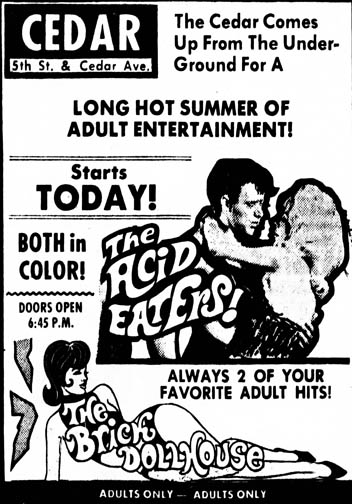
Minneapolis Star, June 13, 1968
The theater was billed as the Cedar Underground Cinema from November 14 to December 6, 1968. The one below appeared when John Lennon was still a Beatle and Yoko Ono was still his girlfriend.
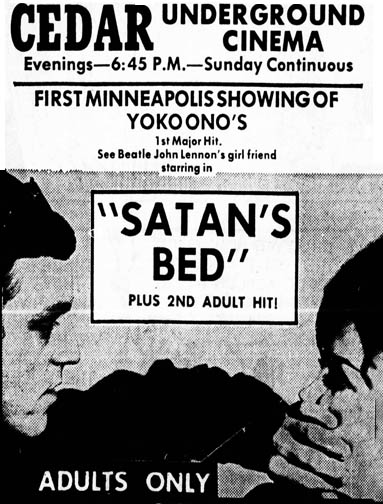
Minneapolis Tribune, December 6, 1968
The last ad for the Cedar Theater, again showing adult movies, may have been on January 23, 1969.
THE CEDAR VILLAGE THEATER
On March 1, 1969, the newly renamed Cedar Village Theater became the home of the Contemporary Dance Theater, founded by Loyce Houlton. The building had recently been purchased by the Harris Company from Ben Berger. A $33,000 remodeling job created a stage, removing 300 seats – much of the renovation was done by the dancers themselves. The first performance of the now-renamed Minnesota Dance Company was on Saturday, March 15, 1969. (Minneapolis Tribune, Allan Holbert, March 16, 1969)
Other groups rented the theater as well, including:
- The Center Opera Company
- The Minnesota Opera Company
- The Nancy Hauser Dance Company
- The Childrens’ Theater Company
- The Deja Vu Film Society, which screened old movies and shorts
CONCERTS AT THE CVT
The following is not a complete list, but comes from the online resource of the Minneapolis Star and Tribune. Additional listings and photos are welcome: please feel free to contact me.
1970
In 1970 the Walker Art Center began sponsoring concerts at the Cedar Village Theater and others followed suit.
BOBBY BLUE BLAND
Bobby Blue Bland was the first in the Walker series, performing with a six piece band on February 3 through 5, 1970.
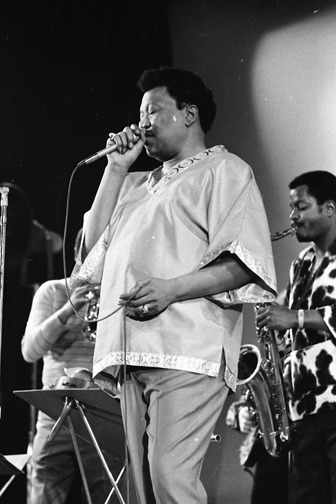
Bobby Blue Bland, February 5, 1970. Photo copyright Mike Barich, St. Paul
DOUG KERSHAW
Doug Kershaw, March 2, 1970. Kershaw was backed by local band Bamboo, and Will Shapira’s review the next day in the Minneapolis Tribune indicated that there was a clash of styles between the two. Also frustrating Kershaw was a crying baby during “Louisiana Man,” and a phalanx of photographers at the edge of the stage. He cut the second set short at 10 pm.
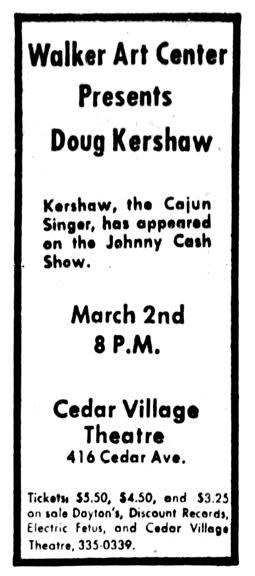
Minneapolis Tribune, 1970
HOWLIN’ WOLF
Howlin’ Wolf appeared on April 2, 1970, sponsored by the Walker.
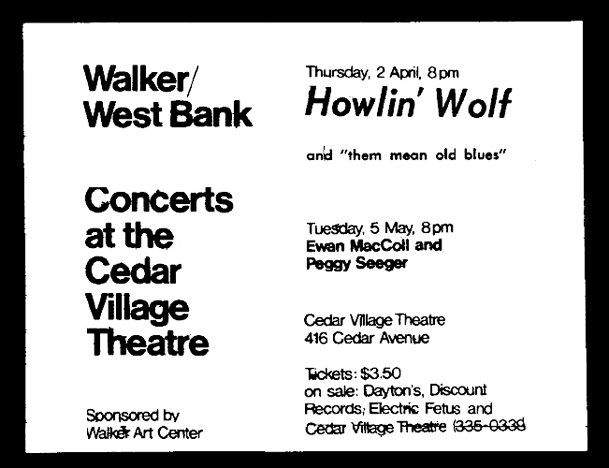
Minnesota Daily ad courtesy Robb Henry
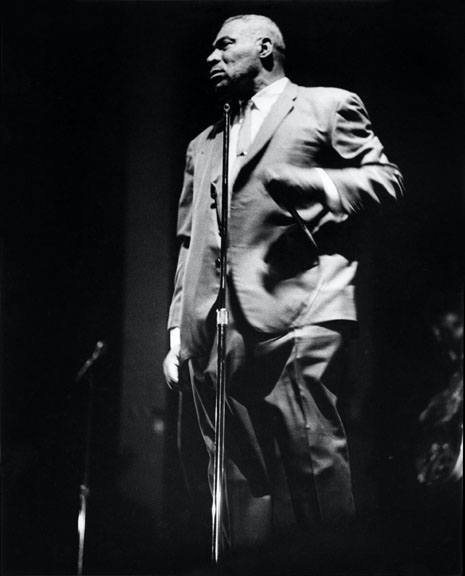
Photo of Howlin’ Wolf by David Elrod, courtesy Walker Art Center Archives
Ewen McColl and Peggy Seeger, May 5, 1970, sponsored by the Walker.
Willie Mae Thornton appeared on May 6, 1970. Her appearance was sponsored by the Scholar Coffeehouse.
Nineteenth Amendment, May 19, 1970
HEVY GUNZ
Reviewer Irv Letofsky didn’t manage to mention the date, but presumably on May 30, 1970, a “new and anarchistic comedy ensemble” called Hevy Gunz Industries held the World Premier of their record “Dope on Dope and Dope Doops” at the CVT. The record wasn’t actually out yet, and again, it was unclear whether they played the tapes or acted it out, but the record was to be the first of three LPs, followed by “Right On Time” and “Moon Over Miasma.”
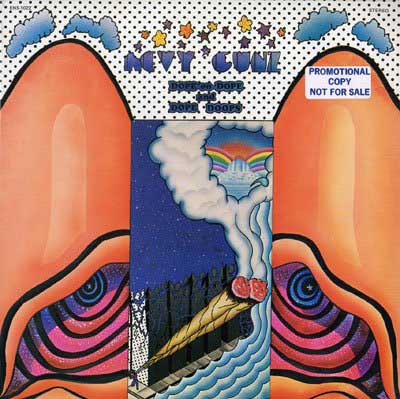
The record was designed for “the dope-crazed depth of the hippie netherworld,” following the efforts of Nurd Nork in his crusade to stop the scourge of dope – the evil weed.” About 500 people attended the event, including three or four infants, a couple of senior citizens, a few of the inevitable narcs, and at least three dogs, two of which got into fights during the production.
The records were being produced by Pandora Productions and Cold Shot Film Productions. The project started when Pandora sponsored a half-hour series on KUXL radio on Sunday nights. Cast members included Paul Davies, Kiki Sherman, Pat Donaghue, Ruth Schroeder, and Sean Blackburn. Some of the radio bits were being taped, but then writer/director Tom Olson (aka Tom Py) was “spooked by an anti-drug radio program run simultaneously on several stations.” He wrote the script for the first album in eight hours, and the cast churned it out in an all-night recording session.
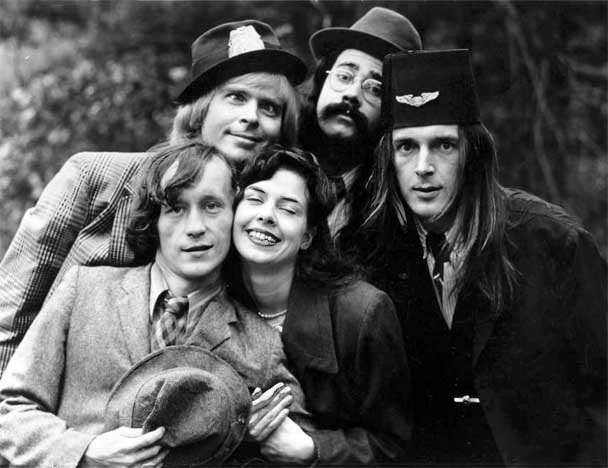
Hevy Gunz Players. Photo from https://hevygunz.wordpress.com/
The producer was Bob Zeller of Cold Shot Films, who was financing the recordings. Zeller was a former instructor at Augsburg College, at the time teaching a film class at the Minneapolis Institute of Arts.
Letofsky found the content to be similar to Firesign Theater, but more political and heavy-handed. “The straights are not likely to get it.” The group tried to get the record played on the radio, but the answer was “No Way.”
The group actually released a double album called “Rownd Wun” in 1970. “Right On Time” is on YouTube. A second one called “Dope on Dope and Dope Doops” was released in 1971 on Enterprise Records.
June 9, 1970: Rock Concert, three bands, it says. Great!
The Paisleys and the Litter, June 16, 1970. Ken Schaffer Concert Series.
June 23, 1970: Ken Schaffer Concert Series.
Sonny Terry and Brownie McGhee appeared on June 30, 1970, sponsored by the Walker.
The Paisleys, July 7, 1970
Mojo Buford Band, with Lonnie Knight playing during breaks; July 28, 1970. Ken Schaffer Concert Series.
White Lightning: August 4, 1970. Ken Schaffer Concert Series.
BEAR, BEAVER, PEACOCK
Local band Bear, Beaver, Peacock and Cassidy performed on September 17, 1970.
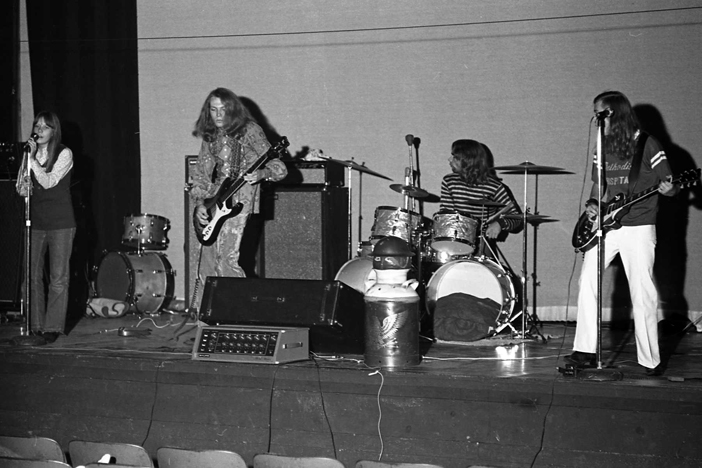
Bear, Beaver, Peacock – September 17, 1970. Photo copyright Mike Barich, St. Paul
Mark Lundeen on guitar, Drummer is Rick Hochstein (Bear) on drums, and Mark Harland on bass. Unknown singer.
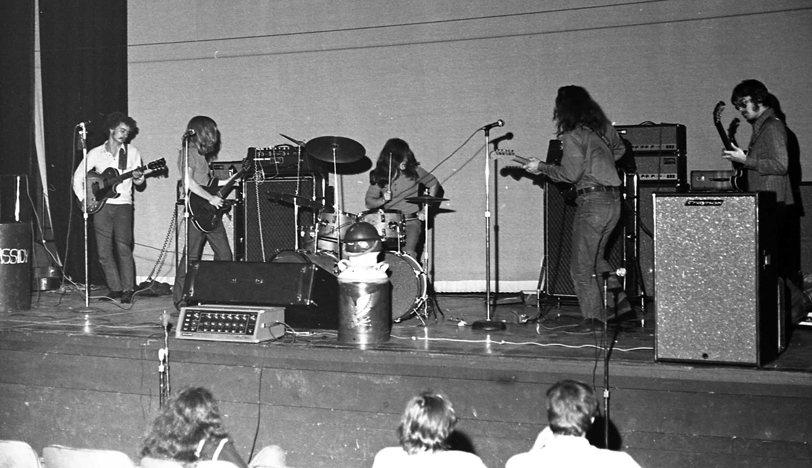
Cassidy, September 17, 1970. Photo copyright Mike Barich, St. Paul
John Hewitt was kind enough to find out the lineup of Cassidy from his Dreamrunners bandmate Chris McGown. The early lineup of Cassidy pictured below, from left to right, is Willie Ries on guitar, Chris McGown on guitar, Mike McClure on drums, Don Strand on guitar, and Dick Crysler on bass. Chris and Don both used Vox Super Beatle Amps. Thanks, John!
Baccanalia, the Marauders, and Ken Schaffer on October 27, 1970.
Charlie Musselwhite Blues Band and Mama’s Home Cookin’ – Lights by Center of Consciousness. November 3, 1970.
Chrickett, the Paisleys, and Dean Carr: November 24, 1970.
“Rock Concert,” December 8, 1970
1971
MORE HEVY GUNZ
Hevy Gunz Industries was back on January 3, 1971, and this time Marshall Fine was not amused. The group had had a lot of buildup in the Minneapolis Tribune and the Minnesota Daily, comparing the troupe to the successful Firesign Theater.
But while Firesign is moving to subtler and more cutting material, Hevy Gunz is content with heavyhanded, tasteless bits about mental retardation and a deodorant for male genitals. No one was introduced and the show started an hour late. They did a number of funny pieces and displayed occasional flashes of insightful humor, however. And, admittedly, some of their bad taste humor was humorous. They seemed to be reaching and to have the potential to be really funny. But obviously it will take time.
Preceding Hevy Gunz were the Jook Savages, a Minneapolis group from the Cowboy Orchestra Waifs (COW) Band mold. Where the COW Band is bold in its experiments with rhythms and atonality, much like Miles Davis and Don Ellis, the Jooks were just stoned and untalented.
A classic Marshall Fine review! (Minneapolis Star, January 4, 1971)
YELLOW DOG CONTRACT
Yellow Dog Contract, January 29, 1971. Mark Peterson produced this show and drew the poster.
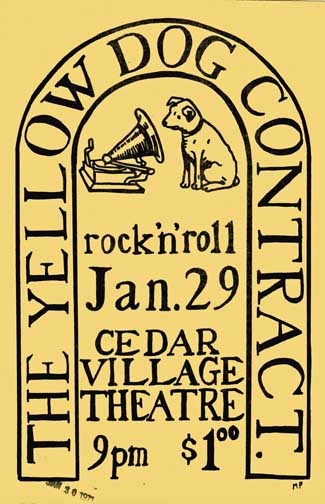
Poster image courtesy Mark Peterson
Stephen Cowdery was at the Yellow Dog Contract Show and was kind enough to send in the photos below:
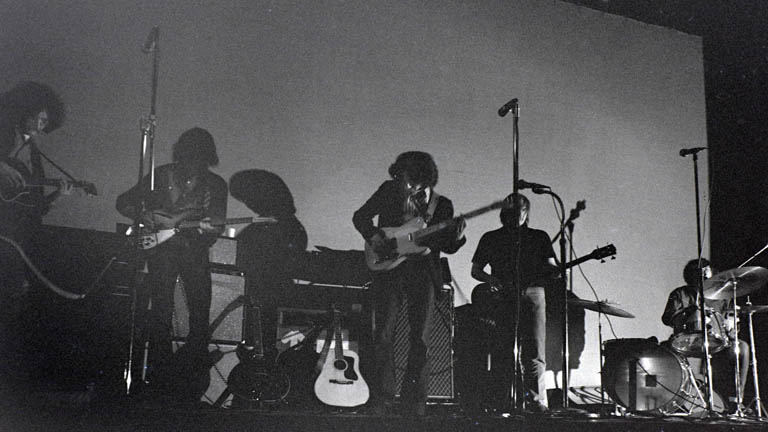
Charlie Broten, Shel Kenyon, David Rummelhoff, Dean Hovey on bass, Richard “Mac” McEvoy, drums. Photo courtesy Stephen Cowdery
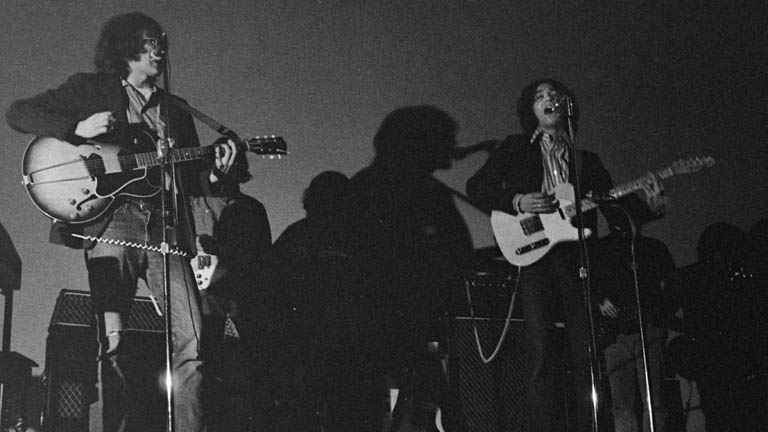
Charlie and David. Photo courtesy Stephen Cowdery
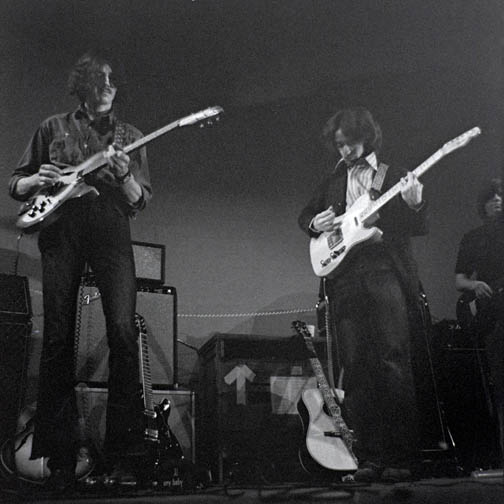
Shel, David, and Dean. Photo courtesy Stephen Cowdery
Thank you to Sandra Kenyon for help identifying band members!
April 11, 1971: Faculty Recital with Dave Ray, Dean Carr, Dean Granrose, Roy Alstad, and Ken Mozen.
Summer Music Festival and Sunday Night Concert Series
July 4, 1971: West Bank Independence Day Festival: American Rock and Roll Music, Noon to Midnight
July 18, 1971: Country Rock
August 1, 1971: Blues
August 15, 1971: Jazz
August 28, 1971: Genesis (all girl band – not part of festival)
August 29, 1971: Rhythm & Blues
September 11, 1971: Cedar-Riverside Autumn Festival (one of several venues)
1972
As part of the Snoose Boulevard Festival, on April 8, 1972, Anne-Charlotte Harvey performed at the Cedar, along with Festival organizer Maury Bernstein and dialect comedian Steve Benson.
The Grande Illusion Cinema hosted screenings of classic and art films at the theater in 1972.
1972 was a big year for dance and opera performance at the theater.
1973
On March 4, 1973, Skogie and the Flaming Pachucos had a concert at the Theater, presented by Encore Corp. They were just released their album “The Butler Did It,” produced by David Zimmerman.
April 1, 1973: Willie Murphy and Betty Brenner, and jazz groups The Night Visitors and Mananga performed in what was billed as “An Evening of Jazz and Blues Music.”
April 19, 1973: The Honeydripper No. 1 Revue was made up of Dave Ray, Tony Glover, Willie Murphy and the Bumblebees, and the West Bank Trackers.
The second Snoose Boulevard Festival opened on April 27, 1973, with an all-Swedish concert at the CVT. A Swedish TV team filmed the Festival for a TV special shown in Sweden.
The Honeydrippers, minus the West Bank Trackers, made a return performance on December 2, 1973.
1974
Four “Homegrown” jazz concerts were sponsored by the Cedar-Riverside Arts Council and the West Bank School of Music, funded by the National Endowment for the Arts:
February 24, 1974: Ted Unseth and the Wolverines, Butch Thompson, and the West Bank Trackers. This first concert drew a “raucous full house.”
March 31, 1974: Mike Elliot Trio and the Art Resnick Quartet
April 14, 1974: The Night Visitors and the John Einweck Band
May 19, 1974: Whole Earth Rainbow Band, Scott Fraser, and the Milo Fine Free Jazz Ensemble.
The third annual Snoose Boulevard Festival featured Anne-Charlotte Harvey at the Theater on May 24 to 26, 1974. The opening night was in Swedish. The Festival was covered by the Swedish Broadcasting Corp. and NPR.
CRISIS AT THE CVT
At some point the Cedar-Riverside Arts Council had been the organization that was operating the theater. The Council was funded by a grant, which ran out in mid-1974. This left the theater in the control of Cedar-Riverside Associates (CRA), the company that was developing the area. But the company was facing money problems too – remember the recession of the mid ’70s?
Meanwhile, the theater’s condition had severely deteriorated, and one by one the tenants were moving to other quarters. CRA was looking for buyers or tenants, to no avail. The theater was closed.
BACK TO THE CEDAR THEATER
The theater re-opened, again named the Cedar Theater, on January 29, 1975, showing “Lenny Bruce Without Tears.” It was leased by Ridgeway Theaters, Inc, a small, independent company, as described by General Manager Marty Grodin. The theater underwent another $30,000 in renovations, and began screening a variety of films.
The fourth annual Snoose Boulevard Festival did not forsake the Cedar – Anne-Charlotte Harvey held her annual concerts there on May 23 to 25, 1975.
The Cedar also hosted occasional live music – I won’t go too far past my 1974 limit, but the Suicide Commandos and Flamingo appeared there on May 15, 1977.
The Cedar Theater closed again, in May 1986.
THE EXTEMP
In September 1986, the Coffeehouse Extempore relocated to the Cedar. At that point the Cedar had 400 seats and a stage measuring 35′ by 50.’ The University Film Society showed movies three times a week on the big screen. (Minneapolis Star and Tribune, September 27, 1986)
The Coffeehouse Extempore went bankrupt in early September 1987. Its last concert was by folk singer Gordon Bok on September 2, 1977. This left the U Film Society out on the street as well. (Minneapolis Star and Tribune, August 28 and October 25, 1987)
CEDAR CULTURAL CENTER
In 1989, CRA sold the building for $1 to Minnesota STAR, a non-profit arts organization. The group moved into the building in the fall of 1988 and took it over officially in February 1989. It was at this time that the building was renamed the Cedar Cultural Center. The floor was leveled and seating was cut down to 300 – the old seats were donated to the Theater in the Round. The first month was dedicated to Celtic music. Their first concert was held on March 3, 1989. (Minneapolis Star and Tribune, Jon Bream, March 10, 1989)
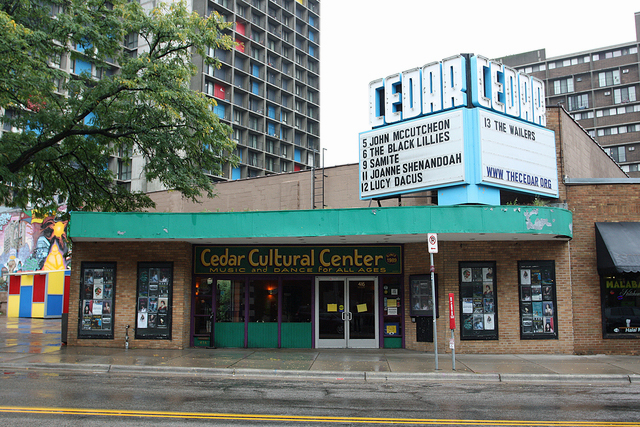
Photo from CinemaTreasures.org
Cedric’s was owned by WCCO radio personality Cedric Adams. It was located on Highway 100 at 50th Street in Edina. The restaurant featured music occasionally and Adams occasionally sat in on drums. The restaurant failed for lack of a liquor license.
The Celebrity Lounge was located at 655 Selby Ave. in St. Paul.
Twins catcher Earl Battey, former Gopher quarterback Sandy Stephens, and Mrs. Zanthia Stone took over the liquor license from Michael F. Munzen on March 1, 1965. They ran it through the spring of 1968.
It advertised on radio station KUXL in 1966.
In 1968 and 1969 it was owned by Mr. Marion Stone. He was later convicted of tax evasion for those years and sentenced to 90 days in the Workhouse.
In 1976 the liquor license was held by Mrs. Mary Page.
Please see More Down Stairs.
The Century Music Hall was located at 5 So. Fourth Street in Downtown Minneapolis.
It was built in 1904, and was used almost entirely for concerts, according to Randolph Edgar.
Below is the view from Fourth Street from First Avenue South to Hennepin.
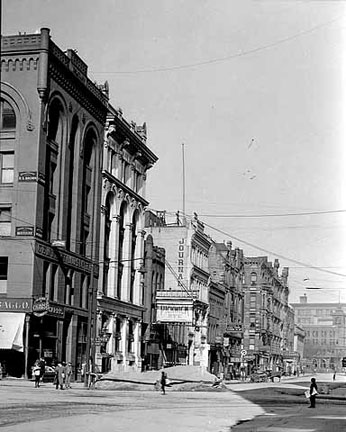
Photo courtesy Minnesota Historical Society
Please see Conroy’s.
The Chalet was located at 3516 No. Lilac Drive (Highway 100).
A June 1963 ad called it “The Northwest’s newest and most distinctive supper club.”
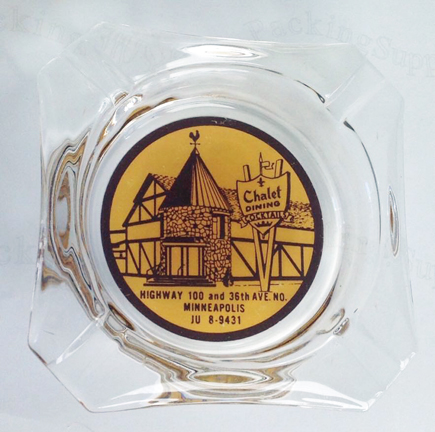
From the Collection of Mark Youngblood
THE ALPINE ROOM
At first the entertainment centered around shows in the Alpine Room. These included professional, national acts such as the following, who appeared in 1963:
- Henny Youngman
- Somethin’ Smith and the Redheads
- Orville Brooks and His Ink Spots – June 6-23. Brooks was the only original member.
- The Flamingos, direct from Las Vegas

Ad for Henny Youngman, Minneapolis Tribune, July 1963
Local chanteuse Nikki North entertained in March 1964.

Local bandleader Big Stoop Chamberlain appeared in 1964

Minneapolis Star
PLAYGIRL CLUB
1969 was a big year for the Playgirl Club, which apparently wasn’t affiliated with Hugh Hefner, but was full of groovy chicks just the same.
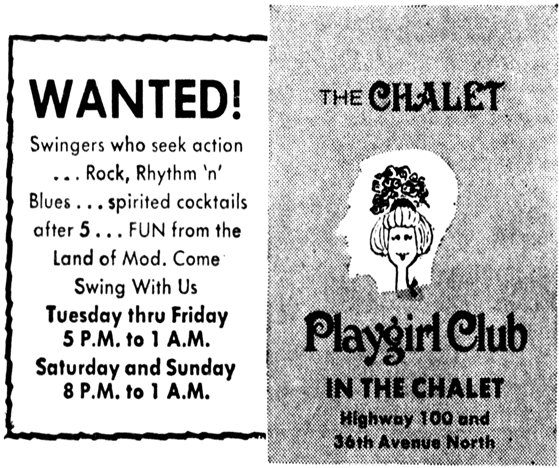
Minneapolis Tribune, January 17, 1969
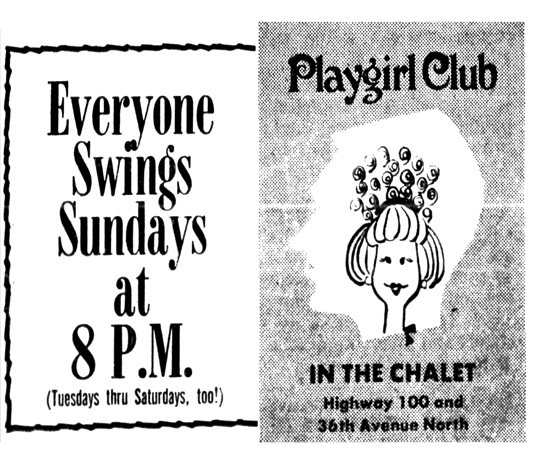
Minneapolis Tribune, February 9, 1969
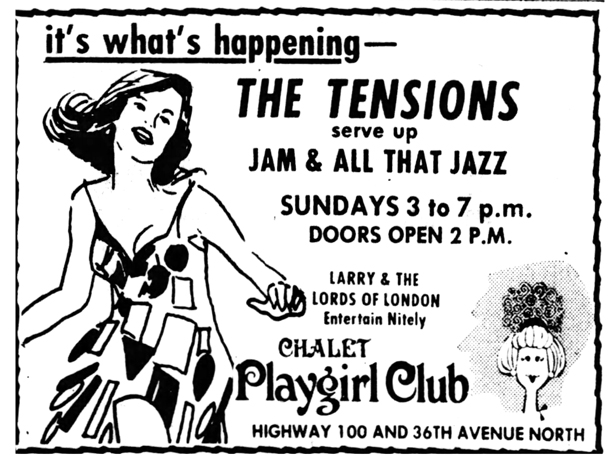
Minneapolis Star, March 21, 1969
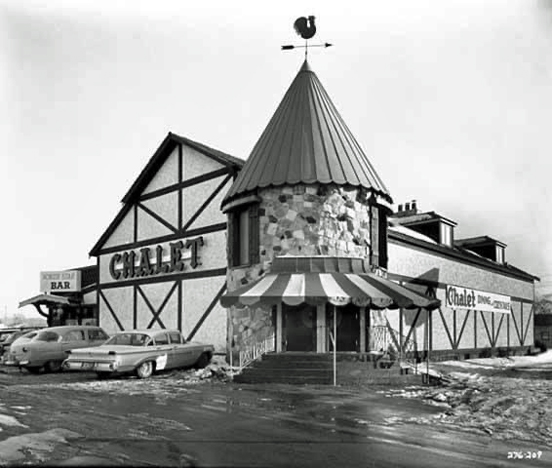
Photo courtesy Minnesota Historical Society
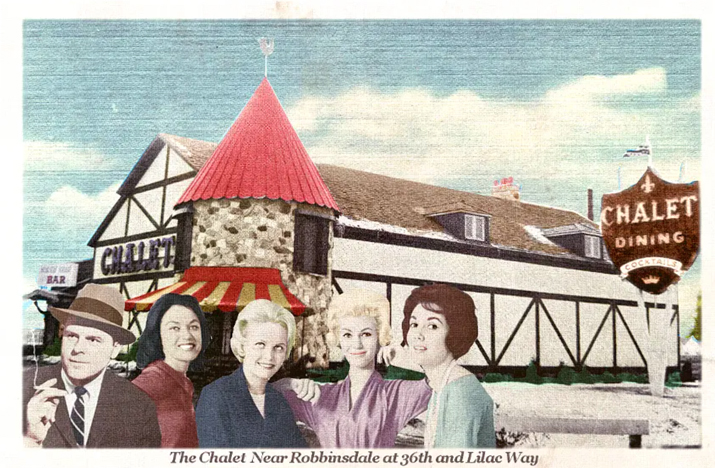
Is this a real postcard? Or just fantasy?
NICKLOW’S
From 1974 to 2000 the building was the home of Nicklow’s Greek restaurant.
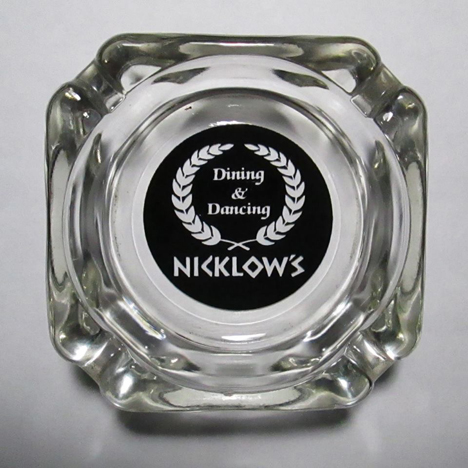
From the Collection of Mark Youngblood
The building was razed for the expansion of Highway 100 and is now the site of the CUB in Crystal.
Thanks to Gary Perna and the Facebook gang for info and memories!
Save
Chanhassan Frontier – apparently had three venues in 1969:
- The Downstairs, featuring The Underground Expression
- Bronco – Doc Evans
- Courtyard – Don Davidson Trio
All I know about this is on this ad!
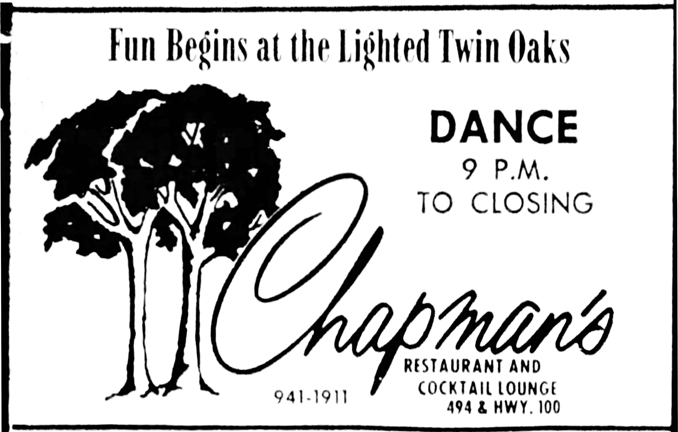
Minneapolis Star, June 9, 1966
Please see information on this venue on Penn Ave in Richfield under Sandy’s Tavern.
Charlie’s Cafe Exceptionale was located at Seventh Street and 4th Avenue South in Minneapolis.
It opened in 1933 and was originally to be run by Charles Saunders and Charles “the Finn” Herlin, an influential bartender. Herlin had created “the President” cocktail (a mix of orange, lemon, gin and finished with a dash of grenadine.) Herlin died soon after the restaurant opened, leaving Saunders to run the cafe until his death.
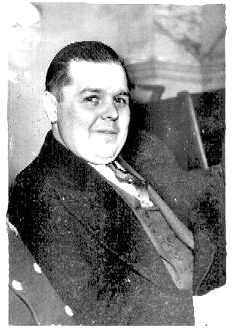
Charlie Saunders. Photo from the Cedric Adams Estate, from Dearly Departed Restaurants Website
The ad below came from a 1939 entertainment magazine, so Charlie’s musical enticements were emphasized:
Rollie Altmeyer at the Hammond Organ and the Novachord. Hmm. According to Wikipedia, only 1,069 Novachords were built over a period from 1939 to 1942. Here’s a photo of one:
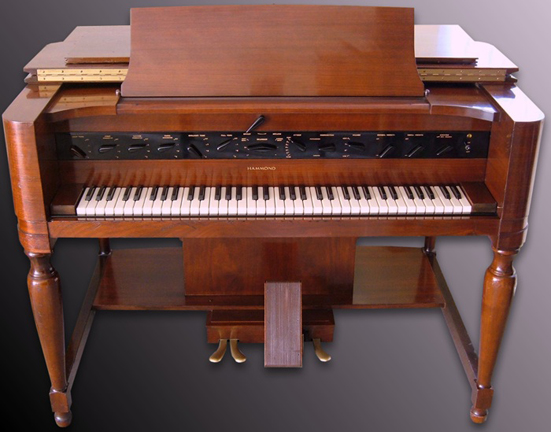
Also, Eunice Johnson singing your requests
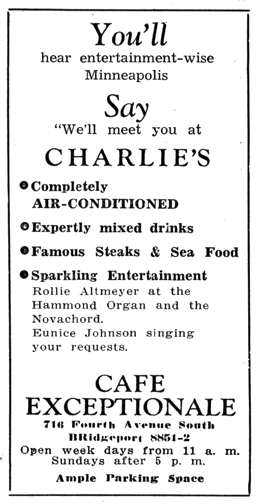
Ad from July 1939
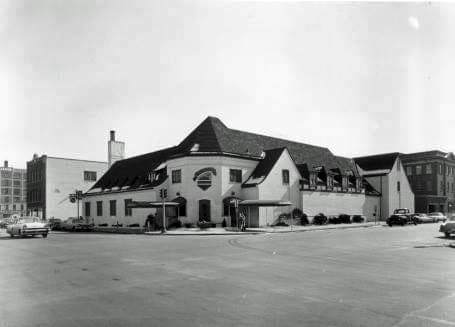
Charlies, 1960 – Image courtesy Minnesota Historical Society
When Charlie Saunders died from a heart attack in 1962, his wife Louise took over running the restaurant. Louise had been a speed skater, was an avid golfer, and was one of the first women to become a partner in a law firm in the Twin Cities. She ran Charlie’s until the end serving as she said, “Beer, bourbon and beef.”
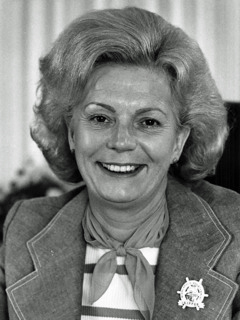
Louise Sanders in 1974 – Image courtesy Minneapolis Star and Tribune
Charlie’s provided entertainment nightly in the cocktail lounge and also had a piano bar.
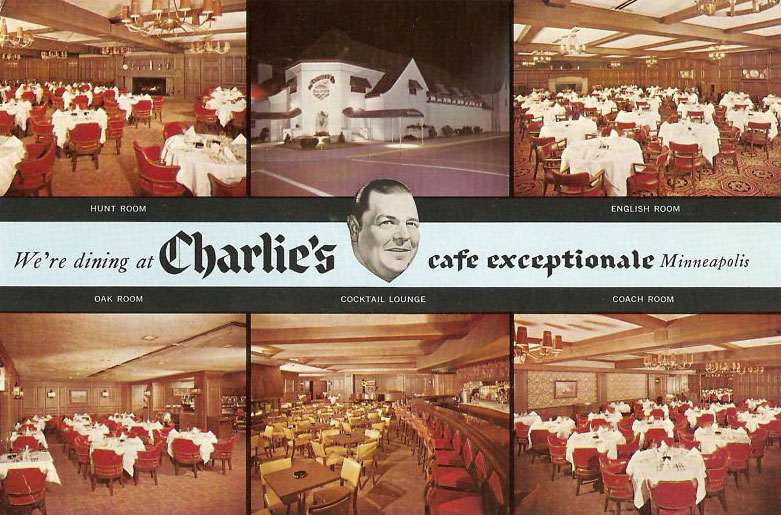
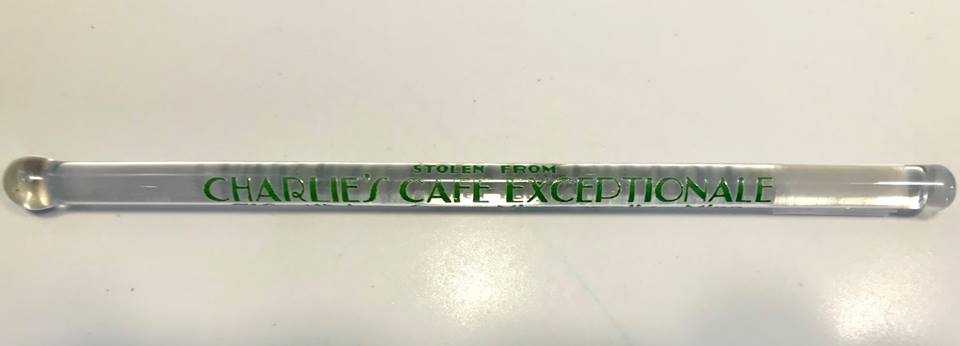
Souvenir of Charlie’s posted by Jarrett Smith
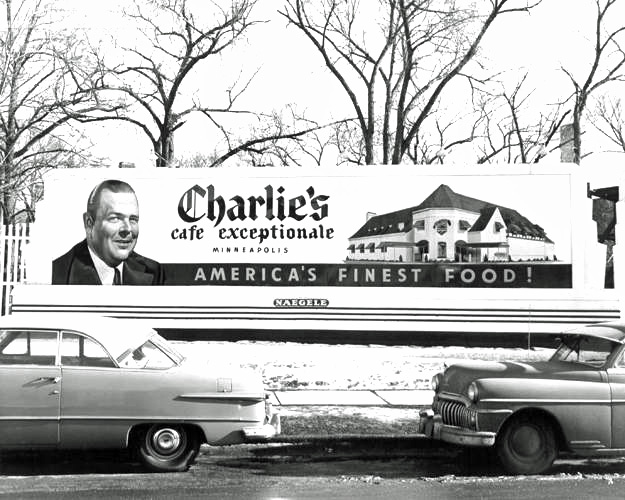
One of Charlie’s biggest boosters was journalist Cedric Adams, who patronized the place so often he had a sandwich named after him.
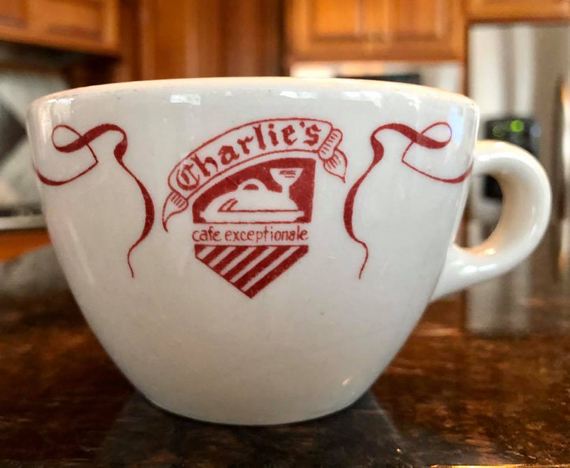
Charlie’s coffee cup – Image courtesy Dianne Damman
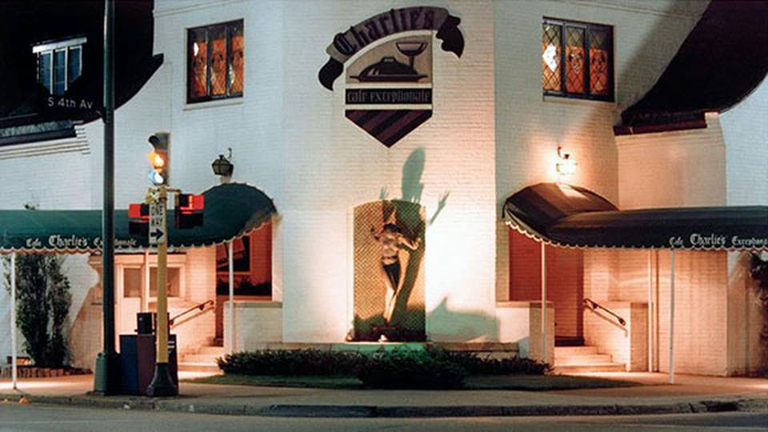
1980
The statue in front was called Scherzo, created by Sylvia Whitney Frishmuth. It was originally located in a roof garden at the Foshay Tower. It was sold to a private party for their home.
Facebook fact: Go to the Super Eight in Bloomington and ask to see the wall mural of Charlie’s.
979 Rondo at Chatsworth, St. Paul
Tracing the history of buildings in St. Paul is more difficult than those in Hennepin County because fewer resources are online (or I am unaware of them), including the St. Paul newspapers, so I am left with the Minneapolis newspapers, and helpful comments on Facebook. But I will give this a try!
A NOTE ON ADDRESSES
There seem to be three addresses in play here:
389 Selby was the original address of the Chatterbox. The first mention of the place that I found in the Minneapolis newspapers was in March 1938, but it could have gone back as far as the end of Prohibition, which was April 1933.
We see 389 Selby in a note dated March 1946 about the bar being remodeled.
On September 26, 1950, in a report about a robbery, we learn that Robert Whiteside was the manager/bartender.
391 Selby was a four-story apartment building that went back to 1908, if the address stayed consistent. In 1948, a 20 ft. high stairway collapsed and six people were injured.
393 Selby comes up in the St. Paul Globe as a combination commercial/residential building going back to at least 1890. Businesses at the turn of the last Century included a dry good store, a plumber, a beauty parlor, a massage school (ladies only), and Korn’s Rental Emporium, which rented bicycles, all the rage at the time.
393 was the Bakke Variety and Department Store in 1962, before the 1965 fire. This became the address of the Chatterbox, as evidenced by a note/ad in December 1985 and another in April 1992.
THE BEAUX ARTS THEATER
Information about this theater comes partially from the website Cinema Treasures.
The Elk Theater opened in 1912 to 1917. There was also an Elk Theater at 2707 E. Lake Street in Minneapolis – and one in Elk River. There was an ad in November 1912 at 393 Selby.
It was called the Rialto Theater from 1917 to 1918. (Not to be confused with the Rialto at 735 E. Lake Street in Minneapolis)
It was renamed the Summit Theater from 1918 to 1933. On June 28, 1924, proprietors Mr. and Mrs. William A. Cameron were shot by a bandit after they closed the theater. Mrs. Cameron died of her injuries and left a considerable sum to her husband, the paper was sure to report. The address was given as 39, Selby! Their typo, not mine!
It was then renamed Beaux Arts Theater from 1933 to at least the 1950s.
In 1935, a story about a fire identified the Beaux Arts Theater at 391 Selby. The theater had 200 patrons at the time – it reportedly seated 300. 22 apartments had to be evacuated as well. Two years later, in a story about fraud in “Bank Nights” at the Beaux Arts, the address was given as 393. And in 1938, a story about a robbery stuck to the 393 address.
Cinema Treasures says that the site is now a parking lot.
1965 FIRE
On August 8, 1965, a 4-alarm fire broke out at the Abbey Apartments, which were adjacent to the Chatterbox Bar and Supper Club, as it was referred to in the newspaper report. The owner of the Chatterbox was listed as William O. McCann. The Abbey was a four-story brick building that housed 22 residents. Two residents and two firemen were not seriously injured. The apartment building, bar, and Bakke’s Variety Store were destroyed – damage was estimated at $150,000. When fire crews came on the scene, the smoke was so thick, they couldn’t tell if the fire was at the Abbey or the Angus Hotel across the street. More than half of St. Paul’s fire equipment was used to fight the fire. A 60 ft. radio antenna on top of the apartment building belonged to the Yellow Cab Co. of St. Paul – a crane was brought in to make sure it didn’t fall. The tragedy of the fire for the Chatterbox was that part of its insurance was held by a company that was declared insolvent by the Ramsey County District Court the week before, and McCann had not transferred it to another company. (Minneapolis Star, August 9, 1965; Minneapolis Tribune, Paul Presbrey, August 9, 1965)
Facebook comment: The hotel and the Chatterbox burned from top to bottom, and it took three years or more to restore it all. Terrific-sized ice dams flowed out several windows on all but the top two floors – it looked like Minnehaha Falls coming out of each window from the firefighters spraying the structure for what seemed like hours.
In Joe Soucheray’s column of June 4, 1978, Joe named Robert McCann as the owner of the Chatterbox. Robert
Looking for the Chatterbox Bar? Take your pick of several that have come and gone over the years. Some of these are music venues, some of them are not. But I’m including all that I found, just for fun. Here they are, in approximate chronological order.
THE NICOLLET HOTEL
The Chatterbox Cocktail Lounge (and the Minnesota Terrace) were part of a $50,000 addition to the Nicollet Hotel, which opened on October 8, 1936. It gave way to the Chatterbox for Ladies, according to ads in June 1940. From there it seems to have been renamed.
389 SELBY AVE., ST. PAUL
This Chatterbox Bar, owned by the McCann family, goes back to at least 1938. See separate entry for the history of this landmark watering hole.
2229 E. 35th STREET, MINNEAPOLIS
The Chatterbox Bar was located at 2229 E. 35th Street in Minneapolis. An alternate address is 3500 23rd Ave. So. The building was erected in 1922 for $11,000. There were stores on the first floor and apartments above. Supposedly during Prohibition it held a speakeasy behind a barber shop. Other uses of the building included:
- 1925: H.A. Rosenthal Drug Co.
- 1929: Electric Car Shop
- 1929: Charme Beauty Shop
- 1934: 35th Street Pharmacy
- 1937: Burr’s Cash Grocery
- 1937: Barber Shop
- 1949: Hamburger Shop
The first mention I found of this Chatterbox was in January 1955, when there was a break-in. On October 25, 1958, there was an explosion at the bar, which was probably the result of a practical joke gone wrong. Someone had a large firecracker, and two men had to be treated for burns at General Hospital. There were 25 people in the tavern at the time. On June 18, 1960, two customers got “slugged in the head” when they unsuccessfully fought off holdup men who appeared at midnight. A month later, four men were arrested for 13 holdups that had made them temporarily $3,000 to $5,000 richer.
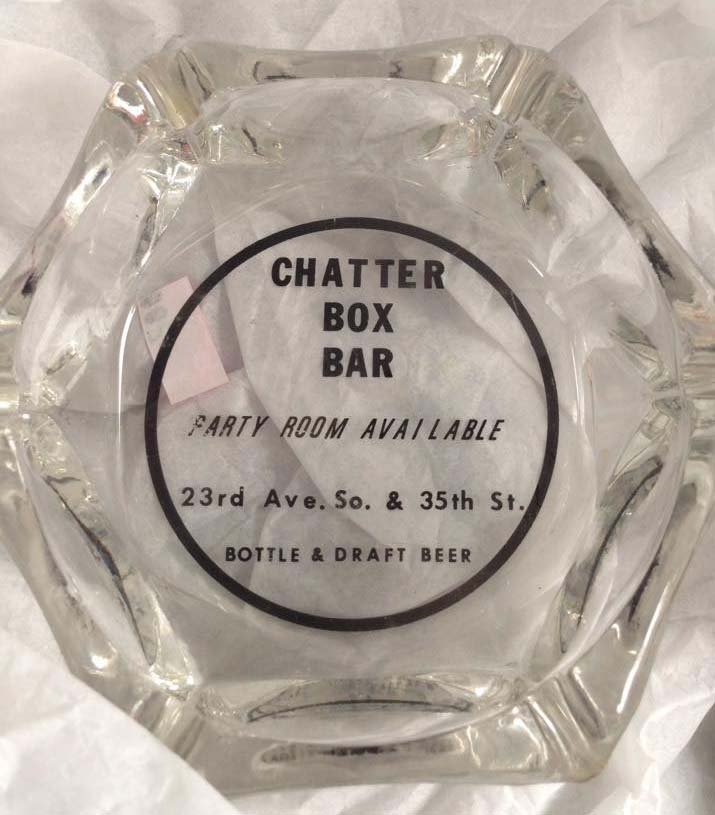
From the collection of Mark Youngblood
In 2000 the Bar had become the Chatterbox Pub, a 3.2 place owned by Steve and Andrea Miller. Actually, by this time it was described as a “Retro Bar/Lounge.” Dancing was advertised in December 2001. A music venue!
Chatterbox Enterprises, Inc. filed for bankruptcy on August 25, 2015, but as of September 2020, Steve Miller is still shown as the taxpayer and the Pub is still open, despite damage from the May 2020 riots and the Covid-19 restrictions.
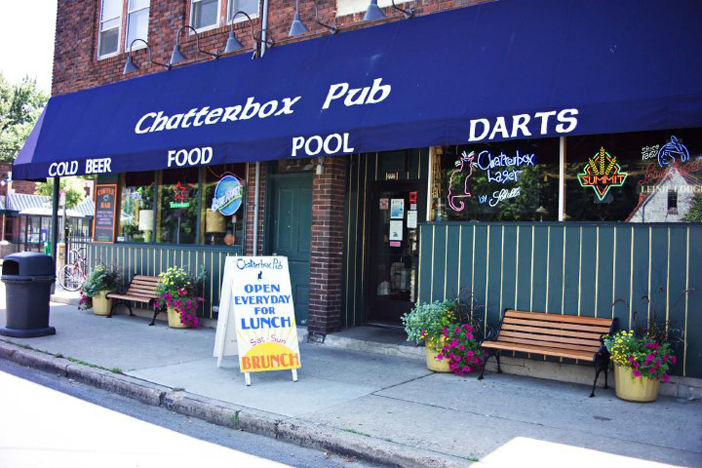
2229 E 35th Street
3675 MINNEHAHA AVE., MINNEAPOLIS
The Chatterbox II was a 3.2 bar located at 3675 Minnehaha Ave. in Minneapolis. This was a large, half-acre lot at the confluence of Minnehaha Ave., 37th Street E, and 33rd Ave. So. As far as I know this was not a music venue. The building was built in 1924. The beer license was issued in February 1975, although there was no parking lot and the building was located in a residential neighborhood. It became a biker bar, and the owner “quit,” calling it “too tough” and the crowd “rough.” James Pesis became the new owner, remodeled the place, and reopened it in April 1976 as Jimmy’s Liquor Bar. By 1978 the neighbors had had enough of car doors slamming at closing time and people urinating on their lawns. In 1985 it was Jimmy’s Steak and Spirits.
800 CLEVELAND AVE., ST. PAUL
The Chatterbox Pub was located at 800 Cleveland Ave. in St. Paul, in the Highland Shopping Center. The Highland Shopping Center seemed to have a curse. It was completed in September 1939 on land purchased from the Ford Motor Company. On February 20, 1941, a 4-alarm fire caused $200,000 damage, and killed a fireman who had been on the force since 1918. Fighting the fire was complicated by temperatures that reached 14 below zero, freezing the water as it was poured on and freezing gloves to fireman’s hands. The fire started in the main heating plant under the store – asbestos was burned off the furnace and ignited the wood floor.
Ten years later, on Sunday, April 2, 1951, the shopping center burned again, this time causing $1.5 million in damage – St. Paul’s worst fire in history in terms of damage. 14 out of 18 stores were destroyed in the 4 alarm fire that started in the Cut Price Super Market. Spectators crowded the scene, and many were hit when debris was blasted across Cleveland Ave. The fire was blamed on defective wiring caused by a short circuit in the attic above the Ritter Beauty Shop. This was disputed by the electricians.
Each time the Center was rebuilt. The venues before the Chatterbox were:
- Lee’s Village Inn – In December 1944, owned by Frank and Lora Lee. In 1954, owned by Frank Lee, Elmer Wobig, Lee Starr. Closed abruptly in January 1993.
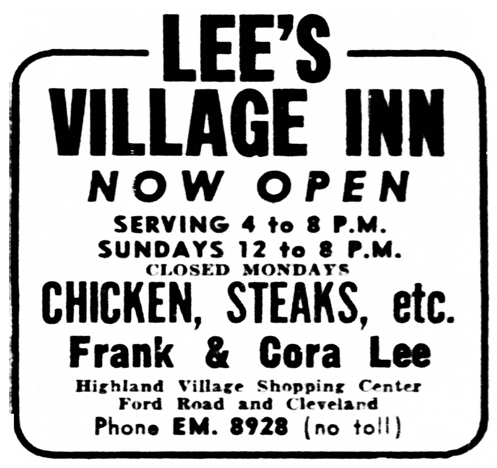
Minneapolis Tribune, December 12, 1944
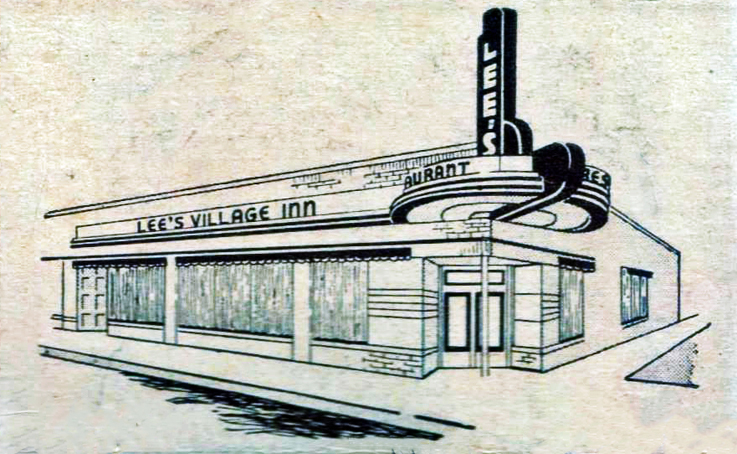
Image of Lee’s from a matchbook; before 1951 fire?
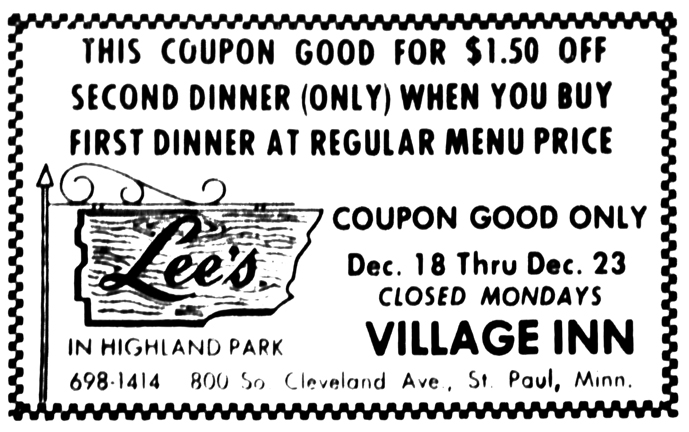
Minneapolis Star, December 18, 1970
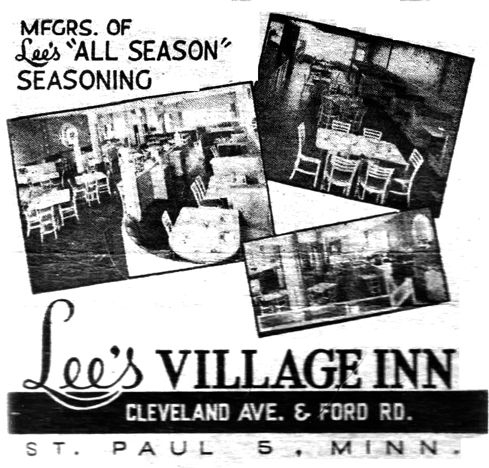
- Doubletree American Grill from 1993 to 1996.
- Perkins
In May 2006, Patrick and Michelle Sayler of Minneapolis opened the Chatterbox Pub. They were inspired by the Chatterbox at 2229 E. 35th Street, but were three times the size. The Pub featured dozens of board games and Atari computer game cartridges, which you could check out. Chatterbox Enterprise Highland Inc. (Andrea Miller, CEO) filed Chapter 11 on November 3, 2015. It apparently stayed open until December 2016.
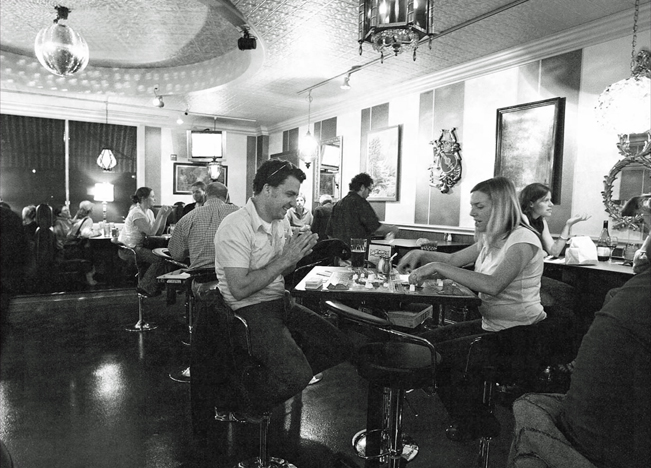
Patrick and Michelle Sayler. Minneapolis Star Tribune, May 12, 2006. Photo by David Joles
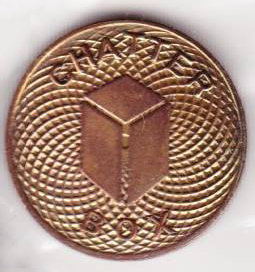
Token posted by Ron Ciccone from 800 Cleveland
Please see Whiskey Go Go
Chick’s Steak House, per Kenneth Stuart, “was a popular watering hole and I was there only once and that was to see some of the Woody Herman Band sidemen come and sit in with the house band. Seems that was the thing to do after name bands closed at other venues, namely the Prom Ballroom. Saw Woody Herman there the night I went to Chick’s. Woody, at that time, had the Four Brothers sax section with Stan Getz, Zoot Sims, Serge Chaloff and Herbie Steward; Bill Harris on trombone; Billie Bauer, guitar; Don Lamond, drums; Ralph Burns, piano; Chubby Jackson, bass and Davey Tough on drums. I can’t tell you how many of the sidemen won the Downbeat Jazz Poll that year but the band totaled seven winners within a short span of years and they were fantastic. I say fantastic and back then it meant something; not just another term like young people use today. The word awesome was not in our lexicon then. had a house band and was also the site of after hours jamming with national acts that were in town such as Woody Herman’s band in the ’40s.”
This teen center in Chisago City (admittedly far afield from the Twin Cities) had a couple of names.
Mark Karnowski remembers:
The Chisago City Community Center was rented by a couple of different promoters in the mid to late ’60s. Both renamed the building to suit their purposes. The first group called the location the “Peppermint Club” (because the building was painted a hideous pink).
The other group dubbed the place “The Hideaway.”
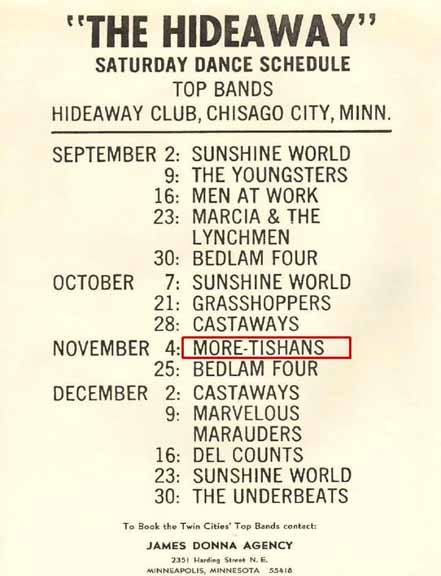
Hideaway Schedule courtesy Mark Karnowski
Mark again:
The groups that played there weekly included the Trashmen, Chancellors, T.C. Atlantic, High Spirits, Stillroven, Castaways, etc. The city stopped renting to the promoters because the events were marred by fights and other problems in the parking lot. I cut a deal with one of the promoters and put up flyers and posters in exchange for free admission.
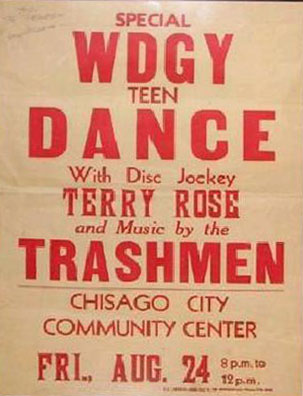
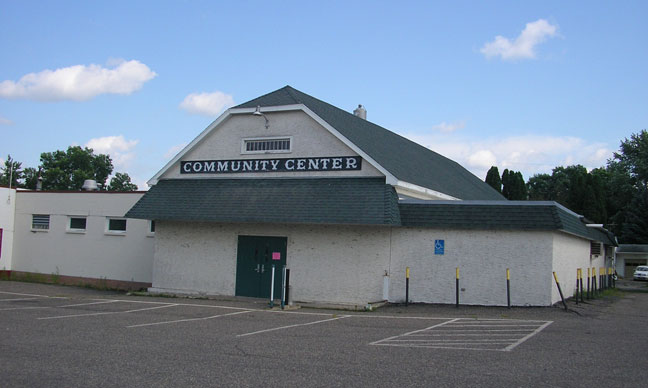
Hey, it was still there in 2014!
In 2022 the building was a brewery called the Uncommon Loon. A call went out for memorabilia from the old days of the dance clubs to hang on the walls.
Chubb’s Ballroom was located in Eagle Lake, Minnesota. Advertised in 1959 were “Teen Age Hops” at the Spring Lake Ballroom (west of Prior Lake on Highway 13), featuring the Jolly Musicians.
Cicero’s was a chain of restaurants equipped with huge pipe organs. There were three outlets that I’ve found, thanks to the folks on Facebook.
ROSEVILLE
The original Ciceros was located at 2100 N. Snelling in HarMar Mall in Roseville, owned by Mike and Karyl Belknap. The organist was a blind-since-birth singer and organist named George Sumner, who also controlled the instruments around the room from the organ and you never knew if something on the wall near you might be employed as the music played. George would put out records occasionally.
On Worthpoint.com, the record below was uncharitably described:
I guess you’d vaguely call it “country” or “country lounge,” but it won’t sound like any country record you’ve ever heard. Here, Sumner and his organ wail and chug their way through Johnny Horton’s Battle of New Orleans, Hank Williams’ Kawliga, Carl Perkins’ Blue Suede Shoes, Shel Silverstein’s Cover Of the Rolling Stone (maybe the album’s highlight) with admirable gusto. A very strange record. Other tracks include: Alabamy Bound, Yellow Ribbon, A Queen on the Kitchen Stool, MacNamara’s Band, others.
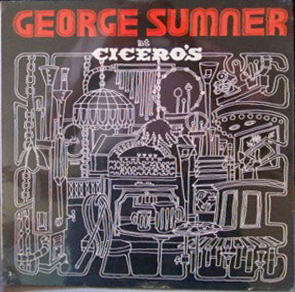
EDINA
The Edina Ciceros was located at 7101 France Ave., inside the Leisure Lane shopping mall. It was owned by Dick and Bonnie Shelley. The restaurant probably opened in 1974, since a flier says that “Beulah,” the “Mighty Pizza Organ,” had been installed there at that time.
Beulah was built in 1930 by the Barton Organ Company of Oshkosh, Wisconsin, to accompany silent films and provide solo entertainment between film performances. Beulah was originally installed in the Paramount Theater in Hamilton, Ohio. She was equipped with special effects, 6 tuned percussion instruments, and 1,100 pipes to simulate orchestral sound and produce pure, physical, unamplified sounds which range from bluegrass fiddles to marching bands. As talking pictures came on the scene in 1930 (just as Beulah was built), many of these pipe organs were discarded and only a handful survived.
Mike Grandchamp was the organist. Here is a video of stills from that location, featuring Grandchamp. Mike’s CV includes working at prestigious clubs, backing strippers on Hennepin Ave., TV gues appearances, concerts, and teaching high school history for ten years. He even installed a theater pipe organ in his own home. He was said to have 2,000 songs in his repertoire.
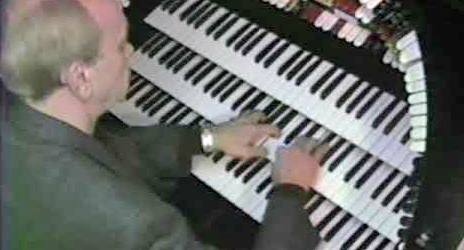
Mike Grandchamp in 2003, courtesy Ed Copeland
An ad from 1974 indicates that Wally Brown was the organist.
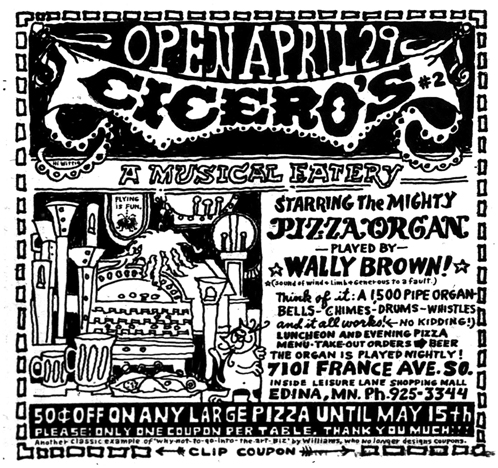
This location closed in 1982.
BROOKLYN CENTER
There was a third Cicero’s located in Westbrook Mall in Brooklyn Center. It was a similar size instrument to the one in Edina, also a Barton, but a big RED console with oriental decor. The organist was Tony Tahlman, who prior to playing at Cicero’s was the organist at the Elm Roller Rink in Chicago. Someone else remembered that the organists were two older gentleman who were brothers.
The following information was researched, written, and provided by Jeff Neuberger, with thanks.
The Cinderella Inn was a roadhouse and gambling casino located at the NE corner of the intersection of Cleveland and County Road D in Arden Hills. The inn was on a ten-acre site near Lake Johanna.
It was owned by Herman Mitschlager and T F Hoban. Mitschlager was better known as Herman Mitch, who was involved with several gambling dens around town.
The Cinderella had a small orchestra that led to its demise. The banjo player in the orchestra (Dixieland?) was named James Paist. Paist was paid $5 a night to play. From October 21 to December 4, 1933, James Paist also made use of the Cinderella Inn’s dice and roulette tables. As you might guess, he lost: $4,000 to be precise. By day Mr. Paist worked as a bank clerk at the St. Anthony Park State Bank. He wrote checks to cover his losses and then took money from bank customers’ accounts to cover the checks.
It was bad luck for Mitch and Hoban that James Paist’s godfather was Herbert Keller, an attorney and a former mayor of St.Paul. Mr. Keller accused the men of cheating his godson with crooked games. Mitch, Hoban, and two other employees were charged with operating gambling equipment. Also charged was Harry Muggley, a Ramsey County Special Deputy Sheriff. Muggley owned a bowling alley in St. Paul and was a bowler of some note.
The men were convicted in December 1933 and sentenced in January 1934. Mitch and Muggley got a $200 fine and 4 months in the workhouse. The other three men got lesser fines and workhouse time. Paist’s family and friends paid back the $4,000 so he was not charged. Muggley was also fired by Sheriff George Moeller as a Deputy.
By 1938 the Cinderella Inn was in foreclosure and the land, a three bedroom house, a barn, chicken coop, two-car garage, and the Tavern were offered for sale for $6,500. The tavern could be leased separately for $35 a month.
Muggley had also been involved with the Plantation Nightclub in White Bear Lake. One might presume as a Deputy Sheriff he kept the law away and may have made sure the Sheriff got his cut.
The Cinnamon Cellar was on Highway 10 in Anoka, open to teens on Saturdays in 1967.
This venue was in Burnsville according to the folks on Facebook. And it had some trouble. Jim Nalls remembers:
Yes, Cisco’s. The band I was in at the time [named Roller] played there, 1981. If I remember correctly the city of Burnsville revoked Cisco’s liquor license. Instead of shutting down, which is what the city was hoping, for they ran bands at the normal time (9:00 – 1:00) and then they had another band from 1:00 – 5:00am, served soda and non-alcoholic beer. After I left they went to more of a hair band, heavier format.
Not really my timeframe, but what the heck? It might have been something else before Cisco’s, you never know.
The City (originally called Psychotic City), was an under 21 dance venue located at 1536 E. Lake Street.
DANCE VENUE
It was started in October 1967 by 30-year-old Rev. Joseph Selvaggio of Holy Rosary Catholic Church, with a group of fathers and sons in south Minneapolis. “Father Joe” had run a youth club at the church for a year, and had the confidence of the teens. One explained, “He understands us and likes the kind of things we like. He helps you out when you’re in trouble.” Another said, “Father Joe can talk to teen-agers a lot better than he can talk to adults; he’s young, and he can remember when he was a kid. Our parents can’t.”
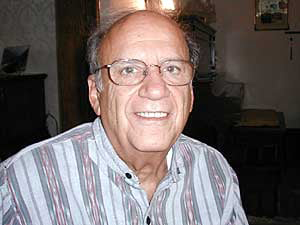
Joseph Selvaggio
An open house was held on November 18, 1967, from 2 to 5 pm, with DJ Scott Burton as MC. The bands were the Caretakers and the Woodshed Dixieland Seven. The venue started out as a teen center, open every night of the week, with bands on Fridays, Saturdays, and Sundays. From March to May 1968, it was listed as a dance venue for the under 21 crowd.
But from the start, the City suffered from financial woes. When Father Joe left the priesthood to get married in August 1968, the reputation of the center took another hit.
THE CITY EVOLVES
By the beginning of 1969, the City had moved from a predominantly white dance venue to a drop-in center for “hard core delinquents” of all races, and was receiving grants to keep it going. It eventually became a school site: a precursor to a charter school. The City sold the property in November 1985.
JOE SELVAGGIO
Joseph Kenneth Selvaggio was born in 1937 in Chicago, if I’m reading this right. His father was born in Italy, and had his own awning shop in Chicago in 1940. Joe was ordained as a priest in 1965 and served for three years before he stepped down to get married 1968. He and his wife adopted two children before having one on their own. They divorced in 1982, and he married again in 1984.
Selvaggio was a lifelong activist, serving as co-chairman of Minnesota Clergy and Laymen Concerned during the Vietnam war. In 1971 he founded the Project for Pride in Living, which provided funds and volunteers to renovate housing and teach construction skills to low-income people. He headed that organization for 35 years. He is still working on improving low-income housing today.
One of his fans says, “I’m no fan of churches or religion but that guy is a Saint.”
Please see The Park Terrace.
The Clef Club was an important venue on the North Side of Minneapolis, located inside the Kistler Building on Sixth Ave. No. Please see the page on the Kistler Building for information on the Clef Club.
501 University Ave., St. Paul. First mentioned in the Minneapolis Spokesman in October 1955. Proprietors were Alonzo Ellis of Minneapolis and George Green of St. Paul. On October 14 the act was Coffee and His Cups featuring Little Jimmy and his Saxophone.
Nicollet Ave. jazz venue that booked Jerry Berry’s Quartet in 1959.
According to a 1958 article in the North Hennepin Post, Club 26 was located on Hennepin Ave. and 26th Ave. So. It was formerly owned by brothers John and George Pappas. In April 1958 John bought the Alcan Club in Robbinsdale.
University Ave. in Fridley, 1970
This 3.2 bar was located at 12660 Central Ave. NE in Blaine.
CLUB 65
The first ad seen for Club 65 is in November 1962, featuring the Rum River Ramblers and Western nights. The tavern was owned by Pete Guzy, Jr., and by all indications it was always a 3.2 spot. Guzy got in trouble for selling to minors in ’67 and ’68 – the latter resulting in having his license suspended for 30 days.
For help with this intriguing new venue, I joined a Blaine Facebook page and posted the ad for the Inn-to-It Lounge below. Mr. Frank John Sharpe was SO helpful, and recognized it as the old Club 65, which sat on the Highway 65 (Central Ave. NE) service road in an area once known as Johnsville. He had access to a series of Vintage Aerials, probably from the 1960s, and I have included part of one below, which Mr. Sharpe has helpfully labeled for us.
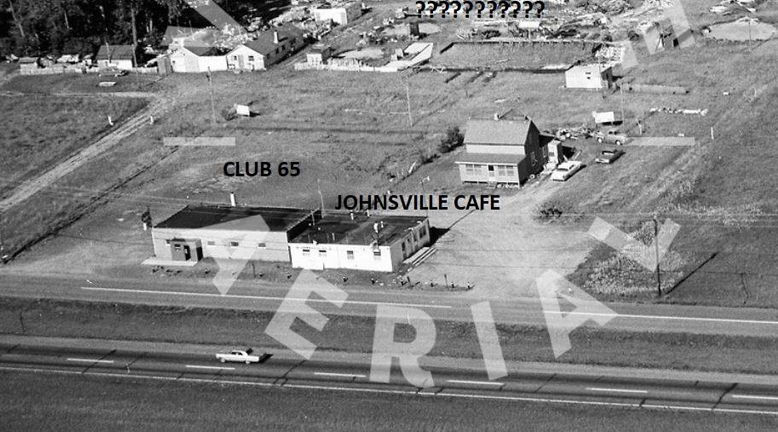
Vintage Aerial courtesy Frank John Sharpe
INN-TO-IT LOUNGE
By January 1971, it was the Inn-To-It Lounge, owned by Doug Driggs. Below is the one and only ad found for the place in the Minneapolis papers. Thanks to Steve Laboe for finding it! Note that the address is nonexistent.
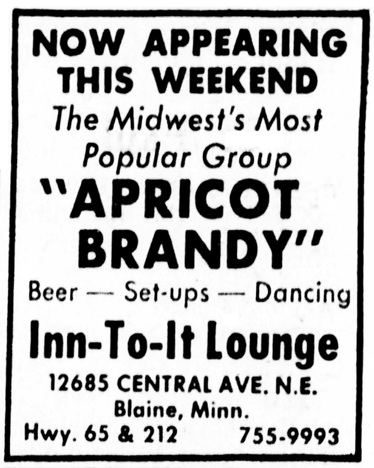
Minneapolis Star, January 23, 1971
A LITTLE TOO IN TO IT
On December 19, 1972, Driggs and an employee engaged in something “really vulgar” and were charged with indecent exposure and lewd behavior. At first the city council refused to renew his license; he hadn’t been convicted of anything, but had broken his promise to phase out “go-go entertainment.” But he reapplied when two council members were missing and got his renewal in February 1973.
There were no hits in the newspaper database after that, and presumably the place was bulldozed as a public nuisance – it was remembered as an empty field for quite a while until the Emberwood Apartments were built on the site.
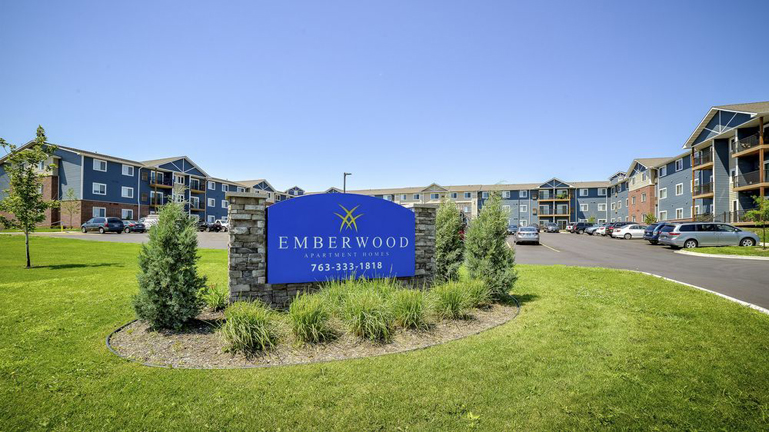
So many changes were made to the area where Club 78 was located that its location can be described several different ways. I kind of went down the rabbit hole on this one, but drive-ins and carnivals and such all sounded like fun. If there is no source listed for the information in the section below, just chalk it up to Internet factoids that may or may not be true.
In March 1956, a crime report in the Minneapolis Star (see below) gave the address of the Club as 7801 Elliot Ave. in Bloomington.
Perhaps it was on a corner – it was also described as being on 78th Street (thus its name), a bit east of Portland.
And it was often described as being next to the Bloomington Drive-In, which was located at 1101 E. 78th Street – on the southwest corner of 494 and 12th Ave. South. This was the first drive-in in Minnesota and it was opened prior to 1948. It closed in the early-to-mid ’70s.
Nearby was the Collins Mobile Home Court, which was built in the late ’40s. The Collins (Mildred and William) owned a traveling carnival and stored all of the equipment in a vacant lot behind the drive-in and next to the Mobile Home Court (currently Walmart). The Mobile Home Court closed around 1994 and construction began on the Walmart.
ON WITH THE SHOW
Blood ran hot on March 29, 1956, at the Club 78. It was a convoluted story of a man (Perkins) who was accused of ramming his car against that of another man (Ninerson) and in the process breaking a window at the Club 78. This story was mixed up with another story about a man trying to free his dog from the pound, so it was difficult to get the facts straight, but at least we have the street address and the first hit on the Strib database. (Minneapolis Star, March 30, 1956)
The name of the place seemed to go back and forth between Club 78 and Conrad’s Club 78. The ad below uses the latter. Music for dancing was provided by the Modern Mics, featuring Bob Burak and Wally Fuller, performing pop songs. This was 1958, the early days of Rock ‘n’ Roll – wonder if this was a roadhouse kind of a place? No food, no alcohol, room for 200!
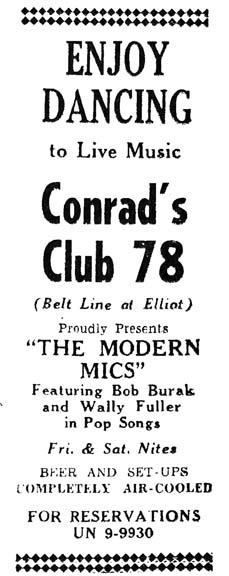
Bloomington Sun, July 24, 1958, courtesy Pat Donnelly
On August 14, 1958, Will Jones referred to the place as Conrad’s Club 78. An article in the Minneapolis Star on January 26, 1963, reveals that the owner was Harold Conrad. Conrad died on June 10, 1963, at the age of 49. His home address was the same as the bar.
The Twin City Tenpin of November 1964 included an ad welcoming bowlers; the ad shows there was live music and dancing every Thursday through Sunday and that the club had a capacity of 200.
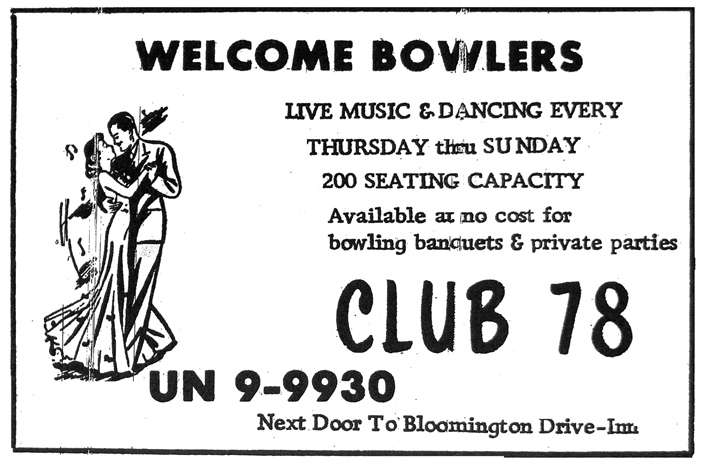
Ad from Twin City Tenpin, December 5, 1964
Fire destroyed the vacant Club 78 on March 28, 1967. It had been vacant for two or three months. It was described as a once-popular, one story, wood framed dance hall. (Minneapolis Tribune, March 29, 1967)
707 Olson Memorial Highway. Opened August 1943 by William “Bill” Freeman – “For an evening of fun.” This site had previously been a hardware store, beauty salon, and Bill’s Smoke Shop. In March 1945 Freeman was fined $100 because a pinball machine on the club premises paid off nickels instead of trade tokens. The machine was found by Oscar Eidern, new Minneapolis police morals squad chief.
Club Carnival was one of three venues at 1523 Nicollet Ave. See the Flame Cafe page for the history of the Happy Hour, Club Carnival, and the famous Flame Cafe.
607 Sixth Ave. No. September 1939: You are invited and always welcome; “Where the Crowds Go”
Club DeLuxe was located in Spring Park, Minnesota.
It dates from about June 1947.
It was for sale in May 1948; the ad said it had a dining room, bar, dance hall, and three bedroom apartment on a one-acre lot. A 1949 ad said it had three dining rooms, it seated 225 people, and that it was established 27 years ago (computes to 1922).
John Mellin was the proprietor in 1950. He was given 30 days in jail for selling beer to minors.
The club was for sale again in 1952 when the owner was called back to service – presumably drafted into the Korean War.
Another ad to sell in November 1954 says the club has had the same owner for 18 years (1936).
South St. Paul
Please see the Cotton Club at 718 Sixth Ave. No.
334 East Lake Street in Minneapolis, showcased rhythm & blues.
Please see the Cotton Club at 718 Sixth Ave. No.
This page is mostly a placeholder for the music venues at 20 University Ave. SE in Minneapolis.
NORDEN HALL
Permit cards start at 1888, when it was built as a Masonic Temple. At some point it became one of many Norden Halls, a kind of Norwegian Masonic equivalent, as far as I can tell. There were two buildings on the lot, at 20 and 22 University Ave. SE., both three stories and both made of brick.
As Norden Hall, it would have been the host of private parties, balls, and dances, as well as meetings.
WHITE SWAN TAVERN
The White Swan went into the space in about February 1933, but ran into trouble in May of the same year, when the holder of the cafe and cigarette permits, Mrs. George Maish, was recommended for denial for renewal for said permits. She was allowed to stay open until midnight on May 13, 1933, in order to get rid of her stock. What she did to precipitate this predicament was unclear.
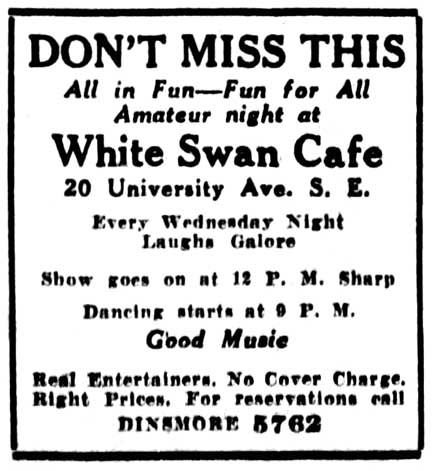
Minneapolis Tribune, December 9, 1931
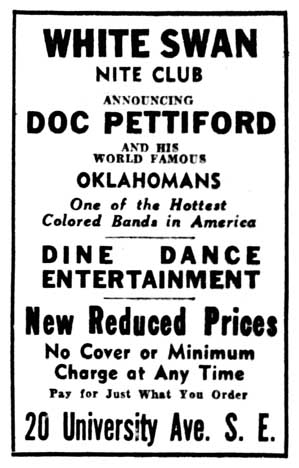
Minneapolis Tribune, February 2, 1933
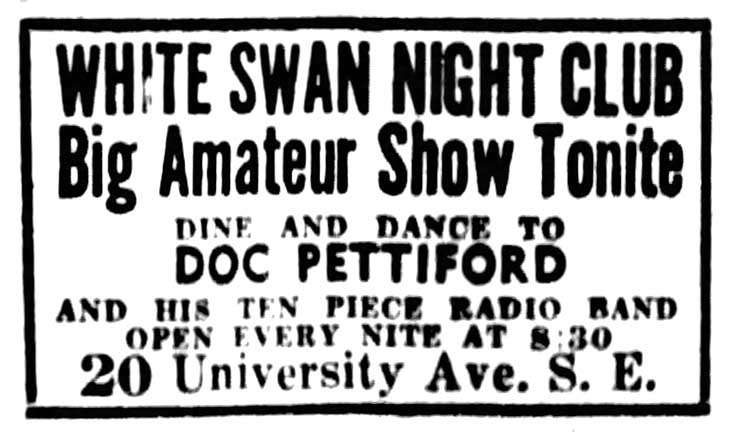
Minneapolis Tribune, April 19, 1933
CLUB ROYALE
By October 1933, the next night club was installed, this one managed by none other than Augie Ratner.
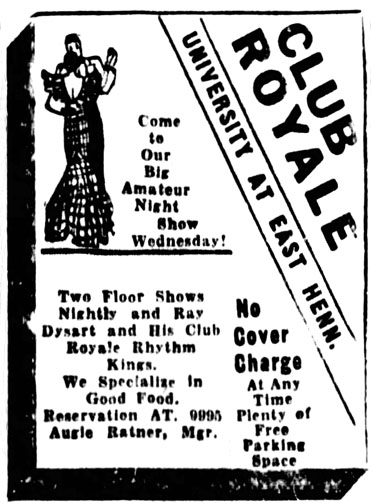
Minneapolis Tribune, December 6, 1933
In April 1943 we see ads for the East Side Christian Center.
DEMOLITION
Both this building and its neighbor were demolished in about February 1961. Although this was about the same time as the Gateway Clearance, other buildings from the turn of the last century remain in that area. These buildings appear to have been replaced by condos built in 2006, but don’t quote me because the addresses have changed.
Demolished were two buildings, according to the permit cards:
- One building measured 24 x 90 x 16
- The other measured 50 x 100 x 40
Yes, Minneapolis had its own Coconut Grove! Near 6th Street over Brady’s, later Schinder’s, newsstand. It had a 14-piece orchestra and a chorus line of eight girls. “Walk up a flight and save a dollar.” In the 1930s it was frequented by gangsters and featured the music of Norvy Mulligan’s 12-piece band.
Please see The Bastille.
THE LEGEND OF COFFEE DAN
Coffee Dan was Daniel Davis, who opened a cabaret in San Francisco in 1879. It operated in various locations in that city until the 1950s, by Dan’s son John after Dan died in 1917. During Prohibition it was a raucous Speakeasy, and the devil drink was delivered into coffee cups (a practice also replicated here at the El Patio and probably many other places around town). Coffee Dans were opened around the country. See more history of this colorful place Here. The photo of Coffee Dan is from that website.
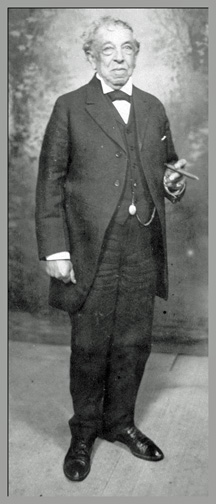
Coffee Dan
A 1925 story in the Minneapolis Tribune identified Coffee Dan Davis as “king of the night restaurants,” and “who had as much money as anybody on the West coast.”
In October 1927 the State Theater presented “A Night at Coffee Dan’s,” the first all-talking short starring William Demarest (yes, Uncle Charley of “My Three Sons”), Nita Martan, and Ray Mayer.
In February 1928 “The Jazz Singer” came to Minneapolis at the State Theater, and it was noted in the Minneapolis Star that some of the scenes were filmed at Coffee Dan’s in San Francisco. In March 1929 there was even a record of the same name.
COFFEE DAN’S COMES TO MINNEAPOLIS
The Minneapolis venue held its Grand Opening on September 23 and 24, 1932, about six months before Prohibition ended.
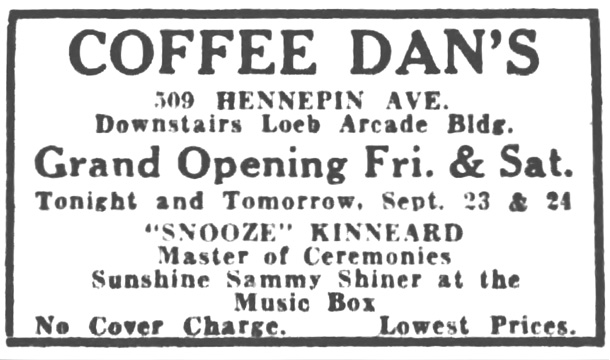
The Minneapolis venue could hold 450 people. It was owned by Frank Falk/Fox and Otto Schimmer.
Musicians such as Hazel Mack and her Sweetheart Revue, Maurice Piche and his Melodians, and the Midshipman played there.
In July 1933 the cafe began heavily advertising its Italian spaghetti – perhaps a cheap entree in Depression times.
On May 22, 1935, Frank Fox and Fan Dancer Ruby Bae were arrested at Coffee Dan’s by “Der Fuehrer Al Palmerstein” of the Minneapolis Morals Squad, saying Miss Bae had too much dance and not enough fan. Miss Bae protested she had done the same dance at a Police stag dinner and no one objected, but Police officials said the stag dance was more tame. Unnamed Police sources told the papers Miss Bae’s dance at the stag was more explicit, but she was convicted of disorderly conduct and Mr. Fox was found guilty of lewd and indecent conduct for allowing the dance to go on. They were each fined $50 or 30 days in the workhouse. Each paid the fine. Coffee Dan’s its liquor license was pulled on May 27, 1935.
Coffee Dan’s was succeeded at 509 Hennepin by Club Lido, also with “Snooze” Kennard at the helm.
The Coffeehouse Extempore has had many lives and locations. Please Contact Me for additions, corrections, or stories about the Extemp.
SMILEY’S POINT – 2200 RIVERSIDE
The Extemp, as it was known as, opened in April 1965 at 2200 Riverside Ave., on the West Bank by the U of M. It was an old apartment with seven rooms, on the second floor over the Smiley’s Point Variety Store/Restaurant. The property is now vacant land owned by Fairview Hospital.
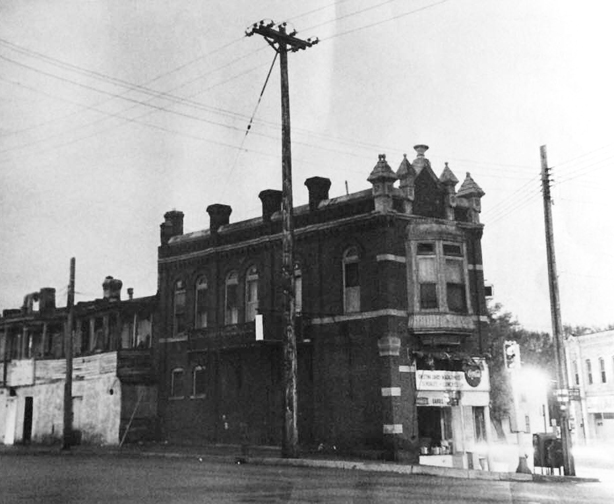
An article by Allen Holbert in the Minneapolis Tribune dated July 3, 1966, stated that it “was founded by a group of friends who wanted a place where people from various backgrounds, age groups, occupations and religions could meet informally for conversation and companionship in a relaxed atmosphere.” Another source says that it was opened and run by a group of laymen and clergymen. It included a small snack bar, a chess room, rooms for conversation, a room for listening to records, a library, and a gallery. The gallery space, initially an art gallery, quickly became the place for musical performances. Holbert wrote, “The Extempore is affiliated with the Coffeehouse Association, which includes some 40 other similar organizations throughout the United States.” A 1969 article in the Tribune said, “Later the hippies moved in and in the fall of 1967 the cafe closed after acquiring a reputation as a center of drug traffic on the West Bank.”
Later in 1967 it reopened under the auspices of youth workers from the American Lutheran Church. The hippies were not drawn to it.
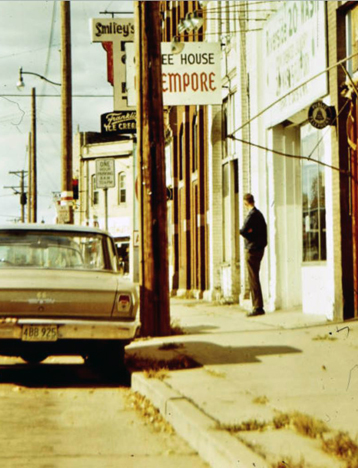
Photo courtesy Hennepin County Library
623 CEDAR AVE.
In May 1968 it moved to the basement of a three-story building at 623 Cedar Ave.
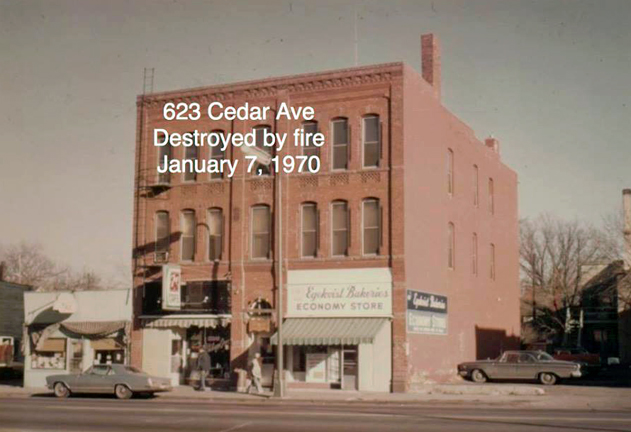
In January 1969 the Cafe was taken over by the West Bank Campus Ministry (WBCM), a loosely organized group of campus religious organization “to give a unified thrust to work with the hippie community.” Members were the Lutheran Campus Ministry, Newman Center, Episcopal Foundation, United Campus Christian Fellowship, Methodist Campus Ministry, University Baptist Church, University Lutheran Chapel (Missouri Synod), Covenant Campus Ministry and Assembly of God Campus Ministry. The Cafe was run by Rev. Gordon Dahl, head of the Lutheran Campus Ministry. The WBCM was also opening other services for the growing runaway and dropout population.
The music spaces in all locations was always called “The Gallery.” Live folk and rock was featured nightly from 8 pm to 2 am with light refreshments offered. The cafe also hosted discussion sessions, club and community meetings, experimental religious services, and courses for the Free University, a self-education program run by university professors and students. Courses included Nihilism Now, Philosophy of Sex, and Existential Christianity.
The feeling and character of the Extemp in 1969 can be no better expressed than by Dakota Dave Hull, who came to Minneapolis from Fargo at the age of 19. Please take the time to read his story Here.
On January 7, 1970, fire destroyed the building at 623 Cedar. It started at 4 am in weather that was -14 with a -48 wind chill. The result was a building that had turned into a solid block of ice. Gas service had to be turned off in the neighborhood, forcing people to find shelter for several days.
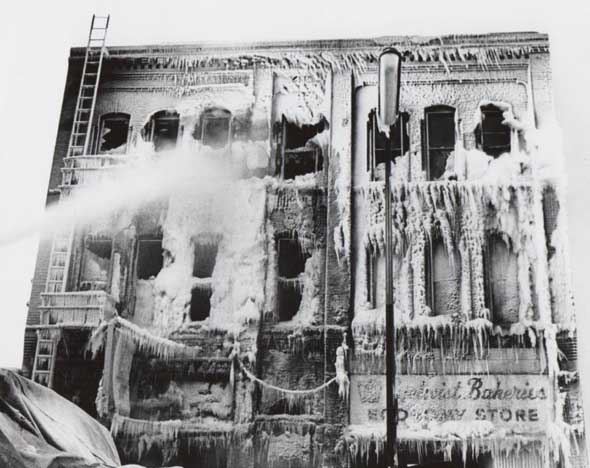
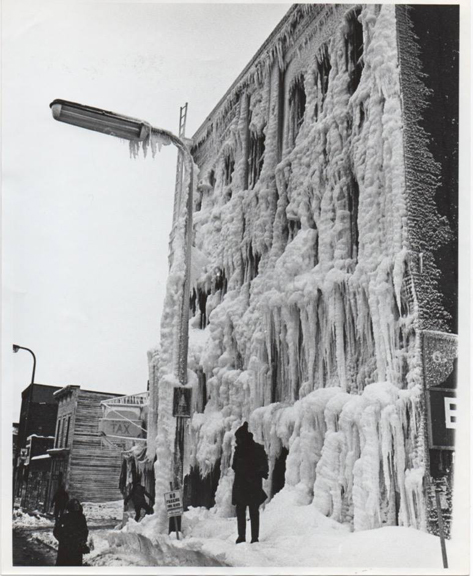
JIM’S BAR – 623 CEDAR AVE.
On the same night of the fire at 623 Cedar, the Extemp reopened at the abandoned Jim’s Bar at 1500 So. 6th Street. There doesn’t seem to be a photo of this location, other than the photo below Extemp sign hanging on the tile wall. Steve Dobbelman notes that “the wooden Extempore sign was still hanging iced over in the arched doorway of the burned-out building. It was saved and moved to each location.” It’s not known who made the sign or what happened to it.
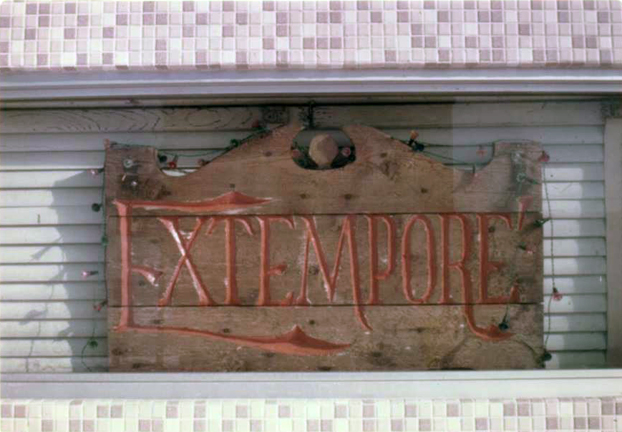
325 CEDAR AVE.
In July 1970 the Extemp moved to 325 Cedar Ave.
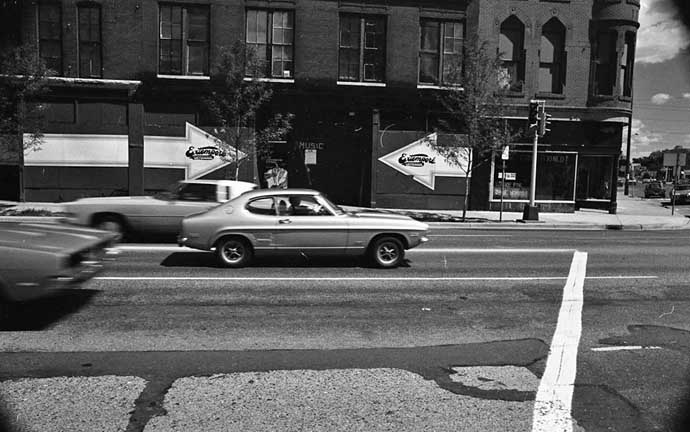
Photo courtesy Hennepin County Library
The building had nine rooms on two floors; confusing enough that a map was included in the monthly calendar!
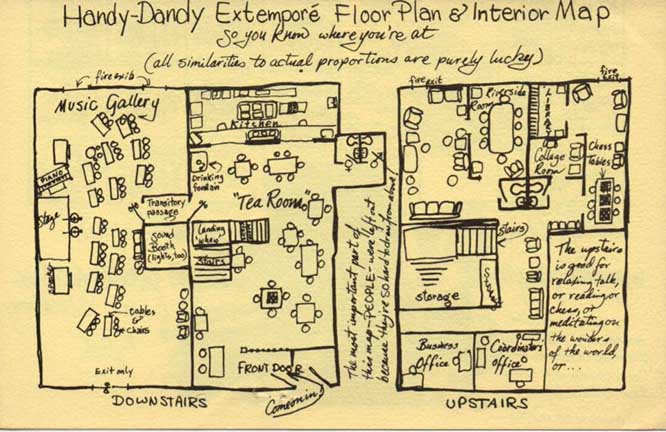
In 1971 Young Adult Centers, Inc. was incorporated to run the Extemp. Created as a non-profit organization, the Extemp was designed to be a place where young artists could perform prose, poetry and music to develop their talents. Run by volunteers and a part-time staff, the Coffeehouse became a well-known spot where musicians and others on the coffee house circuit could perform. Financial problems forced changes to professionalize management in order to attract investors.
In April 1973 a fire necessitated the closing of the entire second floor. After two months of volunteer repairs, all but two of the nine rooms were open.
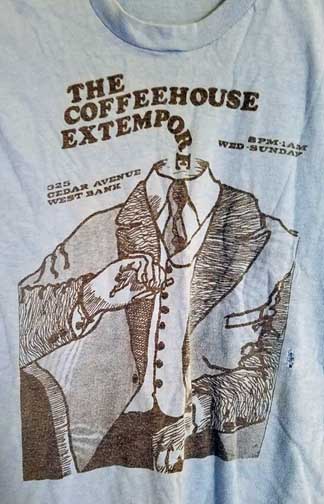
Becky Thompson’s Extemp T-Shirt
LIVE AT THE EXTEMP
In 1975 Steve Dobbelman produced an album of songs, all recorded at 325 Cedar. This LP is a must for any local music collection and might cost a bit.
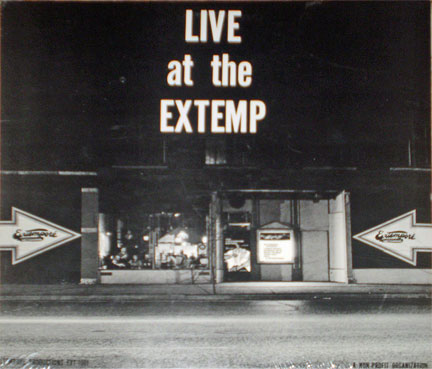
Tracks:
Sean Blackburn and David Hughes:
- Tribute to a Drifter
- Follow Your Own Heart
Lonnie Knight:
- Next Best Thing to Being There
- Little Town
Barbara With:
- Coke Cans and Bottled Beer
- The River
Becky Riemer
- Cowboy
- Baby Lover
Jerry Rau:
- Lonesome Picker
- Streamline Cannonball
Dakota Dave Hull and Peter Ostroushko:
- My Name is Death
- Nine Year Waltz
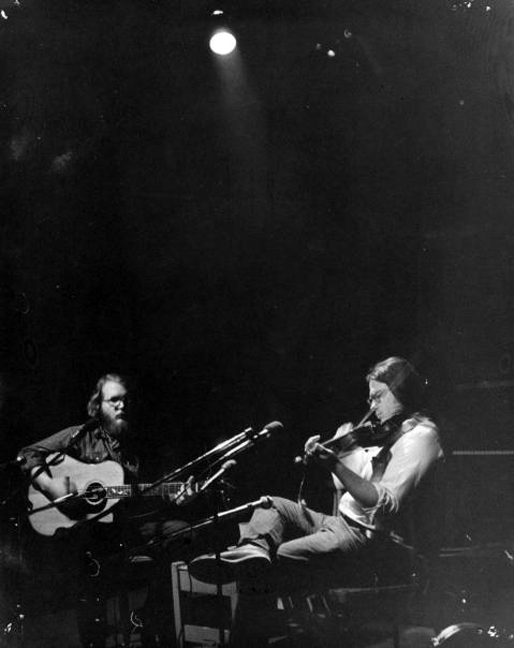
Dakota Dave Hull and Peter Ostrushko – undated photo
In 1982 the City of Minneapolis granted $33,205 to purchase and renovate the building at 325 Cedar. With further fundraising, the building was closed for the summer of 1986 for major renovations, it was announced.
CEDAR THEATER
But fall came and the building wasn’t purchased and the Coffeehouse Extempore as it was conceived was no more. A one-sentence notice by Jon Bream on September 19, 1986, reported that the Coffeehouse Extempore would relocate to the Cedar Theater (416 Cedar Ave.) the following weekend. The next listings were for “Extempore Concerts” at the theater. And on December 5, 1986, Bream reported that the theater had recently been transformed into the “Extempore night club.” Ouch.
THE END OF THE EXTEMP
Facing a crushing $176,0000 in debt, unrelenting overhead, and a changing demographic, on August 26, 1987, the 14-member Board of the Extemp voted to close its doors. The final performance was held by Gordon Bok on Thursday, September 3, 1987. Concert scheduled by Maria Muldaur for September 12 and 13 were moved to the Blues Saloon in St. Paul.
The Coffeehouse Extempore existed in five different locations on the West Bank over the years, providing folk music, comedy, and the companionship not available in a cell phone of today.
Thank you to Steve Dobbelman and Dakota Dave Hull for their assistance and information, and see the Extempore Coffeehouse Facebook page!
2239 Ford Parkway, St. Paul. 1963: Musical Entertainment. 1969: The Internationals Quartet.
444 Wabasha in St. Paul: jazz venue in 1944.
The Coliseum Ballroom was located in the (Lake Street) Coliseum Building at 2708 E. Lake Street.
The 70,000-square-foot, five-story Art Deco building was built in 1917 as Freeman’s Department Store.
It had a huge ballroom with high ceilings on the second floor; ads can be found for dances back to at least 1922.

1920 Photo courtesy Minnesota Historical Society
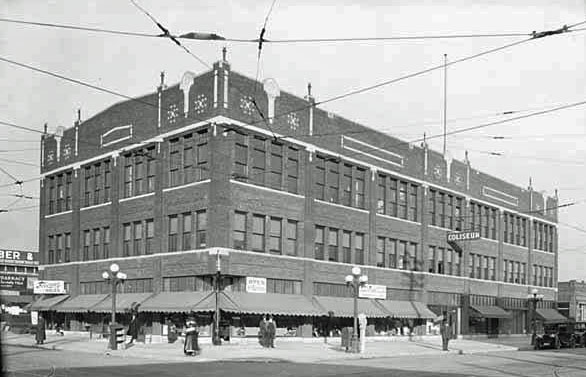
1920 Photo courtesy Minnesota Historical Society
In 1967 it had Old Time Dancing.
In 1968 it was age 28+ “Smooth Dancing.”
The large building held many businesses, such as Podany’s Office Furniture, and doctors’ and dentists’ offices.
It also served as rehearsal space for music groups.
Save
Save
The Coliseum Pavilion/Roller Rink was at 449 Lexington Parkway at University, St. Paul. With 25,000 sq. ft. of dance floor, it hosted dance marathons in the 1920s and ’30s. Wally Erickson’s Coliseum Orchestra was the house band for most of the 1920s and early ’30s. It was the site of many dances held by the black community in the 1920s. It became a roller skating rink until it closed in 1958, owned by Johnny Lane.
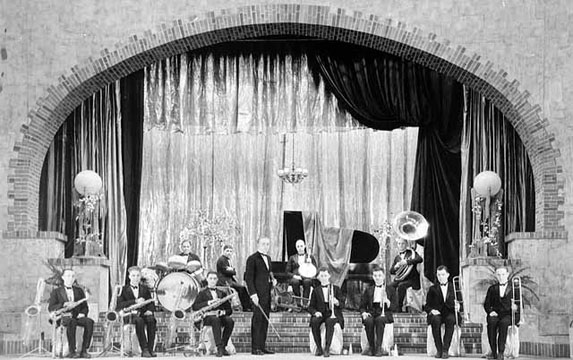
Wally Erickson’s Coliseum Orchestra, @ 1925. Photo courtesy Minnesota Historical Society
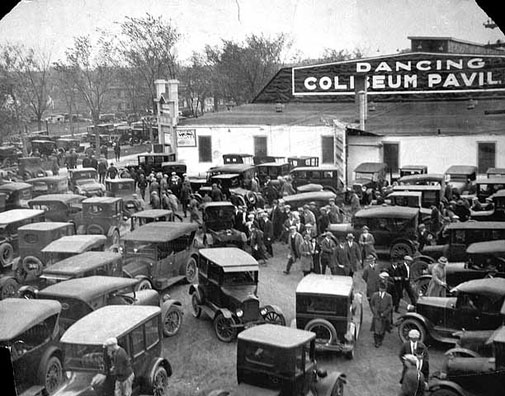
1927 photo courtesy Minnesota Historical Society
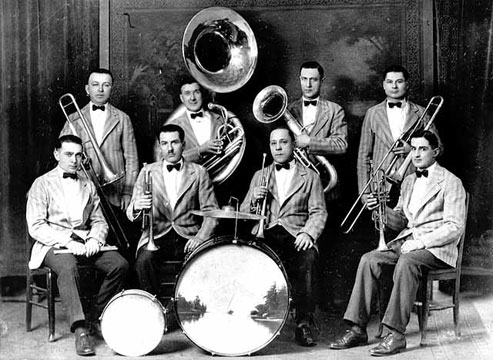
Coliseum Roller Rink Band from 1927, courtesy Minnesota Historical Society.
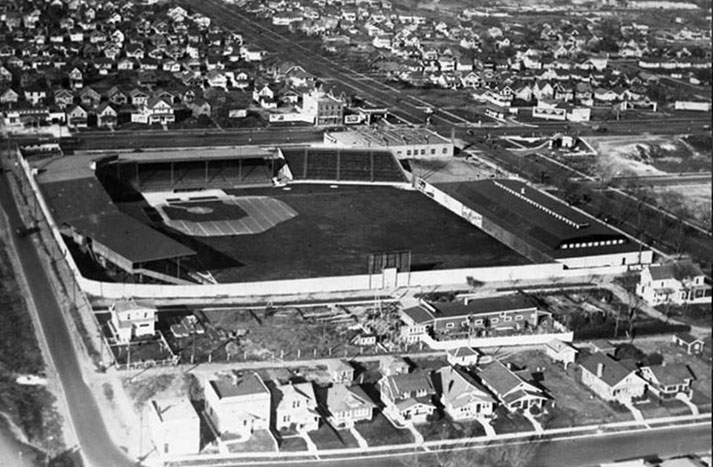
The Coliseum was part of the left field fence for the Lexington Ball Park and patrons could often hear the sound of baseballs hitting the roof. 1930 MNHS. Thanks, Rick Schlosser. The ballpark was demolished in 1958 and the site became a Red Owl Grocery Store. Presumably the Coliseum went at the same time.
Sue Tad Nelson’s father, Sam Spector worked at the St. Paul Coliseum – Sue provided the two photos below, with her father at the left in both of them:
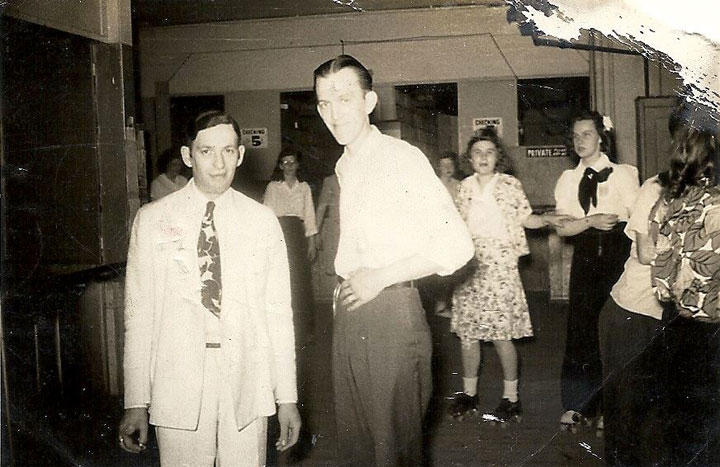
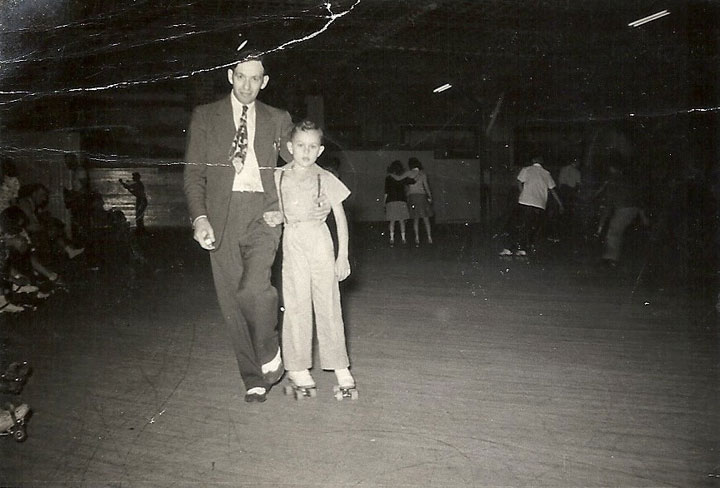
Mendota
522 Marquette Ave. Dancing every evening except Sunday. Possible that it opened in December 1915.
The original Colony Club was a night club in New York, and was replicated at least a couple of times here in the Twin Cities.
WHITE BEAR LAKE
Joined at the Hip describes a club in White Bear Lake as one of the most exclusive swanky night clubs in the Northwest in December 1938. The club was located 13 miles from Dale and Rondo Streets, just a half hour drive on Highway 61.
Could this record be from the White Bear Lake Colony Club?
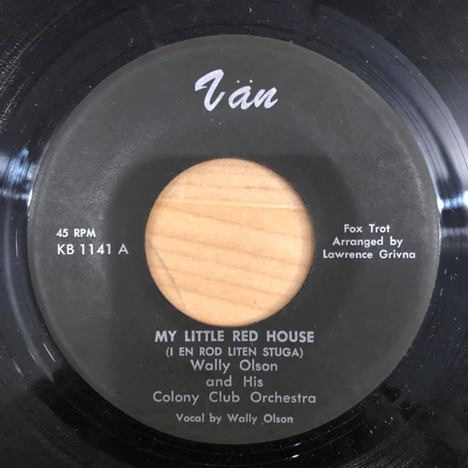
ST. PAUL
Another Colony Club was a short-lived night club that succeeded a Miller’s Cafe in 1952. Click here for those details.
St. Paul. 1946
St. Paul: Home of the Wolverines.
Lake Minnetonka. Site of dances in the Excelsior area in the 1920s.
(More to come on this post)
This building, dated to 1954 by the County, has had a lot of different names and several different addresses. Amazingly, it is still in use today! The address seemed to change a lot, although the building never moved… It’s just that Hudson Road underwent many changes on its way to Highway 94.
- Highway 12
- 2210 Hudson Road
- 2210 Old Hudson Road
- 2181 Suburban Ave.
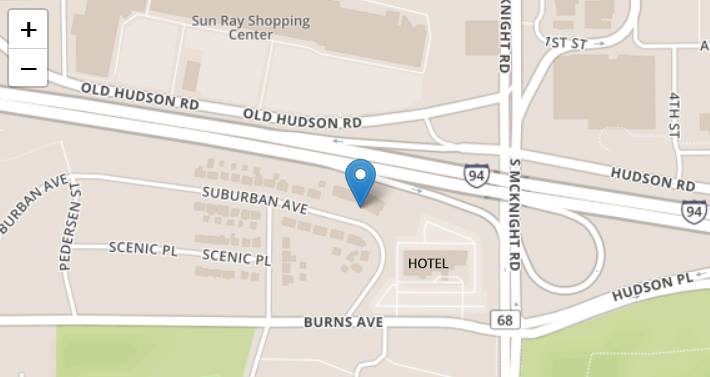
And the building had many residents, including:
- George Conroy’s
- Knight’s
- King’s Inn
- Chain Link
- Studio 94
- Palomino
GEORGE CONROY’S
Conroy’s opened in 1956.
Jeff Dayton posted the following:
This is an artist rendering of an ad for George Conroy’s on Highway 12 (now I-94) across from Sun Ray Shopping Center. My grandparents owned it and I loved working there as a kid. Note the Monday chicken dinner special for $1.85!
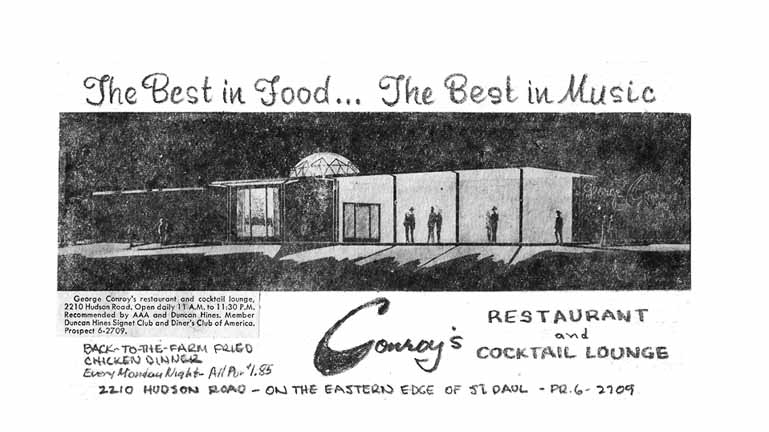
Mr. and Mrs. George A. Conroy were the in-laws of Mr. and Mrs. George D. Dayton, Jeff’s parents.
Jeff remembers that the future Joan Kroc worked as a hostess at Conroy’s.
Mary on Facebook remembers that the glass dome on top had to be covered with a tarp because it reflected the sun and was a problem for planes flying to Holman Field or Lake Elmo’s airport.
The restaurant was heavily advertised in Select magazine, with this distinctive drawing:
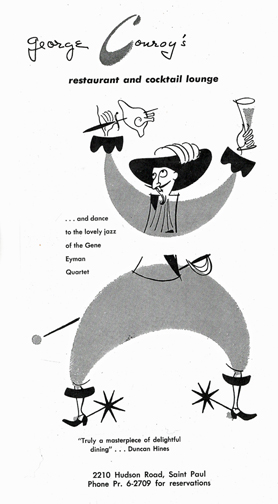
Select Magazine, February 1960
Music tended toward jazz, with the Gene Eyman Quartet providing the entertainment for many years. In May 1961, an ad featured Don Anderson on jazz harp.
In January 1962, Conroy’s had joined the Twist fad, announcing “It’s all new music for dancing at George Conroy’s!” The Twisters (an originally-named group) performed every Tuesday, and the Kings Men were on every Friday and Saturday. Starting March 2, 1962, Dr. Henry Blackburn would make his debut, playing his Sidney Bechet Straight Soprano Saxophone with his quartet.
The restaurant closed in 1965.
THE KNIGHT’S
The first evidence of The Knights is in May 1967, where it is advertised as a Lebanese restaurant. Shish-kebab was served among the palms and beaded curtains…. or you could get a steak. (Minneapolis Tribune, May 7, 1967)
It was still The Knights in January 1968.
KING’S INN
In an article dated December 11, 1970, Don Morrison of the Star reported that he went to check out the new St. Paul branch of the King’s Inn, only to find that it was the old Conroy’s. Owner George Theros, owner of the St. Louis Park restaurant of the same name, had put $250,000 into the St. Paul location – “not as a gaudy display, but as class, as understated opulence.”
The main, formal dining room (called the Archives, one of the things I wouldn’t have done) is a gracious, subdued area of well-dressed tables and banquettes. The walls are lined with bookshelves. OK, the books are sawed in half and glued into place, but they provide the friendly restful feel that any book-lined room has.
Artful partitioning separates this from two other dining rooms that abut it. One is an informal but nice cafe. The other, also screened off, is a black-leather, masculine-clubby sort of place.
Across the lobby is the cocktail lounge. It is furnished in overstuffed chairs, grouped into gracious agglutinations. The walls are luxuriantly adorned with dado-framed silk (or so I thin: I was too comfortable in my easy chair to go look closely) for an elegant living room effect. It is, simply, a beautiful room.
The menu was identical to that in St. Louis Park. At the time, Manny DeSilva, a popular local musician, was entertaining in the piano bar.
CHAIN LINK
The Chain Link was a country bar, in service from about 1972 to 1978. It was owned by Gerry Landreville. Someone named Big Paul Groettum was known to have worked there. Young adults from the nearby 3M facility stopped by after work and had a great time, they remember!
The bands included:
- American Grease
- Good Vibrations
- Rockin’ Hollywoods
- White Sidewalls
- Cleavettes
- Free and Easy
The ad below doesn’t look very good and I don’t know where it came from, but doing a search for “Chain Link” mostly gets you a lot of ads for fencing…
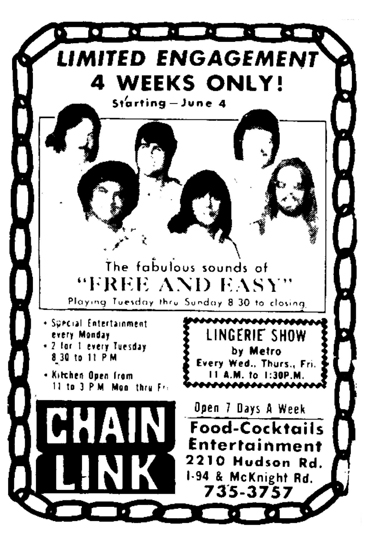
June 1974
Locked in the Cooler
One of those tragedies that sounds like it belongs on a sitcom happened on Sunday night, November 26, 1972, when two robbers set their sights on the Chain Link Bar. Four people working there were forced to go down into the basement: owner Gerald D. Landreville, his wife Jo Anne, employee Laverne Landreville, and employee Quentin Bailey. All four were told to strip to their underwear, and were locked in the cooler.
The holdup men got away with Mrs. Landreville’s wedding rings ($1,200), Mr. Landreville’s watch ($125) and his two diamond rings ($180), Bailey’s watch ($100), and everyone’s wallets (value unknown).
The story went out on the Associated Press, but according to newspapers.com, it was only picked up by five papers (none in the ‘Cities): Bismarck, Sioux Falls, Fergus Falls, Winona, and the Huron (SD) Daily Plainsman. Each had just a bit different headline about being in their undies in the cooler. Just as well.
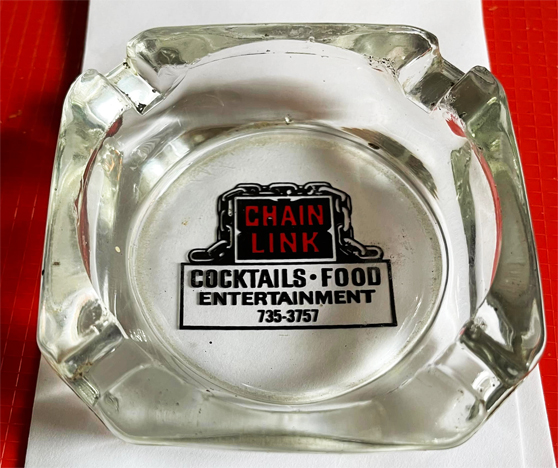
Image courtesy Ron The Don Cockriel
STUDIO 94
Studio 94 was a disco, named after its proximity to Interstate 94. It was one of the few places in town that catered to a black clientele. It was active from about 1979 to 1982.
PALOMINO
Palomino returned to the country theme, riding until about 1992.
BATTLE CREEK HEAD START
As of 2018, the building has been the home of Battle Creek Head Start.
And Russ Hanson, the King of before and after, has made two juxtapositions for us:
In the Google Earth photo below you can see the darker roof as the original outline of the building and the “dome” on top is clearly visible. The front has been added later.
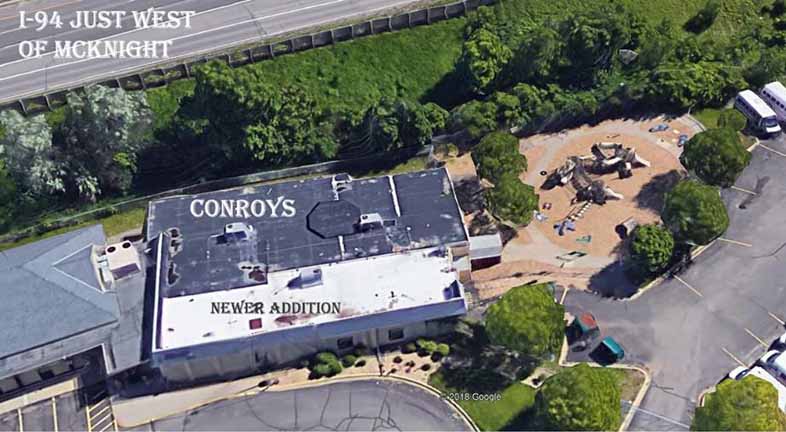
Photo merge by me (Russ) using a Google Earth view and Jeff Dayton’s original advertisement.
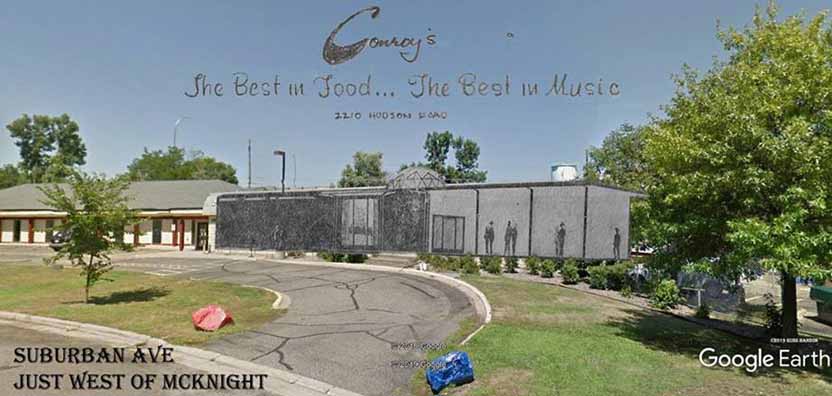
Thank you, Russ, Jeff, and everyone on Facebook who helped solve this puzzle!
Cooks’ and Waiters’ Club was an after-hours jazz and gambling house, probably on South Sixth Street, Minneapolis.
Cooper’s West was located at 1209 West 7th Street in St. Paul. See Stransky’s.
This page concerns all of the businesses I could find at 413 Hennepin Ave., including a couple that were on the second floor. The building was erected in 1888 and divided into a store and a restaurant. Businesses in the 415 Hennepin side are on a separate page under the Saddle Bar.
NEW PALACE CAFE
James Tsiolis opened the New Palace Cafe on October 27, 1916. The place held 40 tables and could serve 150 customers. The Tribune waxed poetic:
Myriads of electric lights will make this place a Broadway drawing card to hundreds of famished pedestrians who will appease their hunger with substantial viands and delicacies as would tickle the palate of the most exacting connoisseur in gastronomy.
On May 2, 1930, it was announced that the New Palace Cafe faced bankruptcy because of unpaid debts. And indeed, its fixtures were advertised for sale that June.
PARAMOUNT CAFE
The next iteration was the Paramount Cafe, which opened in July 1930. It was apparently still owned by Tsiolis. On September 28, 1930, the Paramount had a serious fire, and a firefighter broke his back in the course of fighting the fire. Since two other properties belonging to Tsiolis had burned down and he had collected considerable insurance payoffs, he was dubbed “King Torch” in the press, and investigated heavily by the arson squad. In February 1937 he was found guilty of torching the Cafe.
JACK’S RESTAURANT/DOYLE’S CAFE
Jack Doyle ran a place alternately known as Jack’s Restaurant and Doyle’s Cafe, beginning in late December 1935. In January 1938 Doyle’s was the scene of a heroin deal. The perpetrators were William (Big Bill) Hildebrandt and Joe (Sixty) Katz.
On October 31, 1942, yet another spectacular fire occurred at the site. Spilled grease caught fire and lit up Hennepin Ave. This time one firefighter was killed and three were hurt during the two-hour battle to kill the flames.
In July 1945, Doyle’s was temporarily closed down as Jack was accused of running a gambling house. Interestingly, his lawyer was A.M. Cary, Attorney to the Mob. On July 21, 1945, the Tribune ran a banner headline, “Race Books Closed at Jack’s.”
“‘Cut it Out’ Warns Vice Squad Chief.” Jack’s was described as “one of the biggest, most notorious gambling spots in Minneapolis. Jack was urged to take a long vacation, and that the police department would not object if he stayed away permanently.
Jack’s rolled on, though, with items describing a wife throwing a brick through the window because her date wouldn’t pay the bill (July 1946).
The restaurant (open all night) was still called Jack’s in December 1948, but the operator was named as Arthur Berenson. The building was owned by Mrs. Mabel Bortz. On May 24 of that year, yet another fire killed a firefighter and injured three others.
PIT BAR-B-Q
In June 1959 Sam Polski leased the shop and ran a Pit Bar-B-Q busines until May of 1962. The place was prone to crime and prostitution, and in January 1963 Polski was ordered to show cause why it shouldn’t be shut down. Polski responded that he was going to closed on March 1, 1963. Fixtures were advertised for sale on March 31, 1963.
Meanwhile, the Gateway was being demolished, and the finite number of liquor licenses were up for grabs. The liquor license from the famed Persian Palms was transferred to the Pit Bar-B-Q in December 1962, but was not immediately used.
THE COPPER SQUIRREL
The Copper Squirrel was one of those old, venerable downtown bars that made Hennepin Ave. the hub of nightlife in the 1960s and ’70s. It was owned by Harry “Papa” Smull, described as an associate of Kid Cann (Minneapolis Star, November 19, 1975) who had owned the Persian Palms. At one time members of Smull’s family had owned seven liquor licenses, in violation of city ordinance. (Minneapolis Tribune, April 14, 1976).
The Copper Squirrel opened in August 1963. On September 13, Will Jones reported that the new place had
the old Persian Palms license, the old management, and for a week or so they had what looked like the same old dancing girls and lady MC working there. The only thing new was the address and the shining new wood and copper decor. But the old shows didn’t look right in the new setting, and the management nervously began shuffling acts. This week a Chicago coffeehouse comic was imported. He worked one night, was paid off for the week, and sent back to Chicago. Now they’ve brought in the Hank Hazlett Trio to swing a little, and it looks as though those three will stay awhile. And the show in the back room features Greta Gibson, Miss Sax Appeal, a tall, stacked blonde who blows everything from a Hungarian czardas to “Night Train” on a rackful of five saxophones…
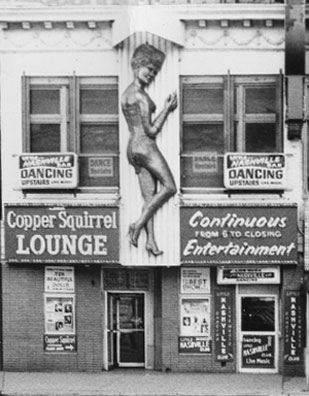
1970 photo from post on Historyapolis Facebook page
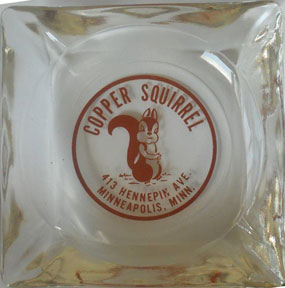
Ashtray and money clip from the collection of Mark Youngblood
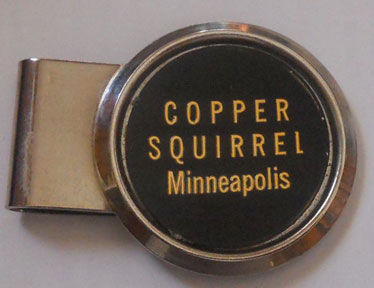
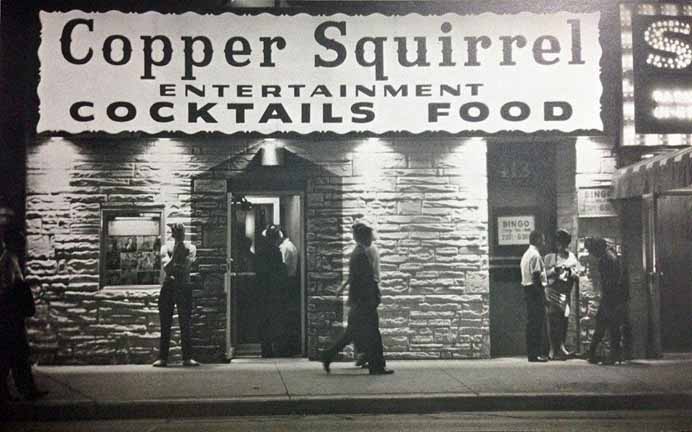
Harry Smull died in April 1972 and the bar became the property of his estate.
SUN DISCO
By 1977 the Copper Squirrel had become a gay bar called the Sun Disco. (Minneapolis Star, November 16, 1977). In June 1981 it was described as the only drag bar in the Twin Cities.
DEMOLITION
NSP bought the building and the Andrews Hotel next door in August 1983. On January 15, 1984, dynamite made quick work of the buildings, flattening them in 7 seconds.
MORE UPSTAIRS
On August 2, the Squirrel opened More Upstairs, a jazz listening room located on the second floor of the building. The first combo was Ira Pettiford’s Trio. But as usual, jazz didn’t draw, and by December the room was presenting rock ‘n’ roll.
LITTLE NASHVILLE CLUB
In February 1969, More Upstairs was replaced with the Little Nashville Club, which was above both the Copper Squirrel and the adjacent Saddle Bar at 415 Hennepin. The address of the Little Nashville Club was given as 413 1/2 Hennepin. Johnnie White was one of the acts in 1969.
The Copper Stein was a restaurant located in the Tonka Terrace Shopping Center, at Highway 7 and County Road 9 in Tonka Bay. The shopping center opened on October 1, 1955.
The first entry found in the Minneapolis papers was on March 1, 1958. It perhaps replaced the early Terrace Kitchens. That first ad billed it as a smorgasbord, which was the set-up on Sundays. The next entry (and these are just classified ads) in May 1958 called it a supper club.
It was owned by brothers-in-law Ray Koberstein and Keith Whitney. Koberstein was a barber, and Whitney was a blacktop contractor, according to Will Jones. (Minneapolis Tribune, June 2, 1958)
Jones described it as:
a place full of dark wood, gleaming copper, round tables and low-beamed-ceiling gemutlichheit.
Matchbook below posted by Luke Lukens.
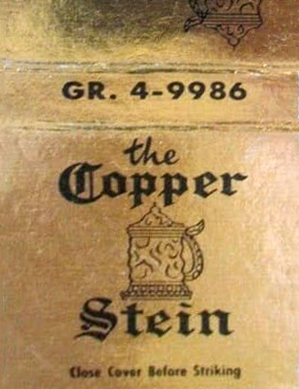
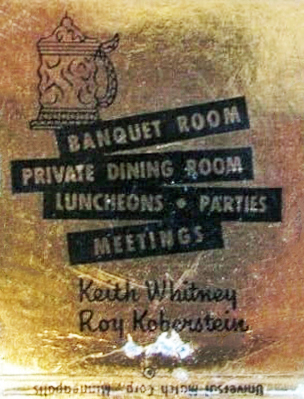
FOOD AND DRINK AT THE COPPER STEIN
Koberstein explained to Jones,
When we started, what we thought we were running was a high-class 3.2 place, but because of the setting, I guess, people kept asking for food.
Chef Karl Lhotsky was recruited, and set to making his European specialties, such as chicken a la pheasant, goulash, chicken Kiev, Russian-style turkey breast, tournedos of beef, and “that unbeatable dessert,” palachinky.
As for drinks, it was set-ups only at first. Diners who brought wine were provided with ice buckets and “handsome crystal.” Those who wanted mixed drinks brought the essentials and were served ice, chilled glasses, mixing implements, olives, and cherries.
MUSIC AT THE COPPER STEIN
Although there was music at the restaurant/supper club, it was not advertised, and not what people remember.
The few references to music I did find were:
The May 1958 ad featured Skeets Reiman at the piano bar in the Cider Cellar on Fridays and Saturdays.
Another source says that Excelsior native Jim Eddy performed at the club.
Dancing was added to the New Year’s Eve Smorgasbord in 1958, reported Will Jones.
And there was this early ad for the piano bar:
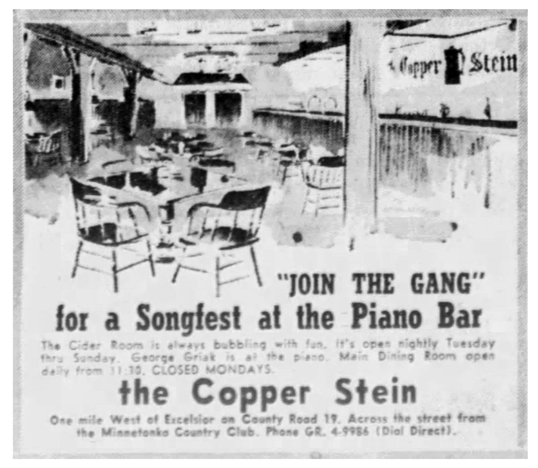
Minneapolis Star, August 21, 1958
In April 1959, Cedric Adams reported that the Copper Stein was switching to a private club. This may have been an attempt to get a liquor license. The private club status was dropped in December 1959.
In July 1963, the Tonka Terrace Shopping Center was renamed Country Club Plaza.
On September 10, 1963, a fire burned out two rooms and caused fire damage to a third. Keith Whitney was identified as the owner, and he estimated the damage at $60,000 to $70,000. The grand reopening was on December 6, 1963 – by this time the development was called Minnetonka Plaza.
In October 1964, an ad identified it as Aldritt’s Copper Stein Restaurant.
In May 1965 it was called Murphy’s Copper Stein.
In July 1979, the owners were Richard and Betty Wakefield.
The Copper Stein closed, to become a variety of other eateries, in March 1997.
Golden Valley. Not sure about this, but I have a picture of the billboard, so here goes!
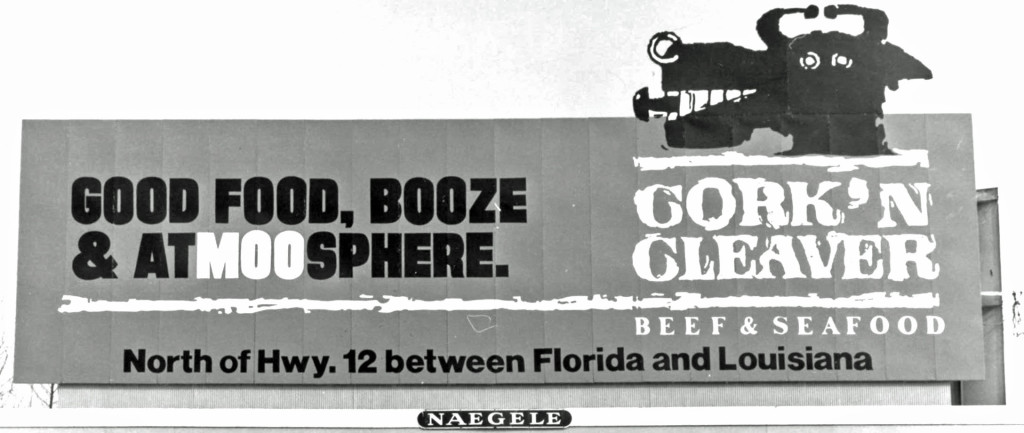
16 So. Sixth Street, Minneapolis. Swing Lounge, 1970.
The Coronado Cafe was located at 1581 University Ave. (at Snelling) in St. Paul. Many thanks to Bob Jackson for information for this page!
THE BUILDING
The St. Paul papers are not online, but a search through the Minneapolis database finds people living at this address as early as 1911.
From at least 1924 to 1930 it was A.F. Kurth’s Pharmacy
CORONADO CAFE
The first mention of the cafe is in February 1939 when there is a robbery (love those robbery reports). At first it was a going nightclub.
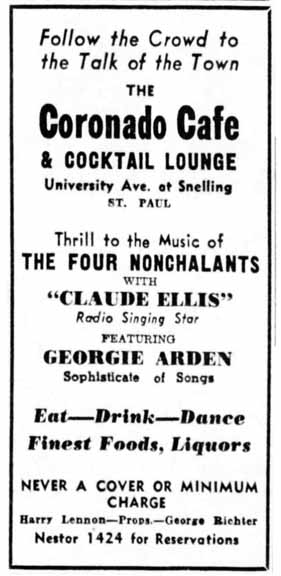
Minneapolis Tribune, October 21, 1939
After a few upscale ads like this, the notices quickly became more like classified ads. But there were these matchbooks:
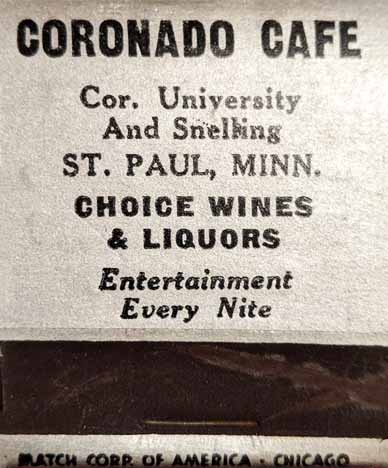
Image courtesy Bob Jackson
And thanks to the Minnesota Historical Society, we know what the place looked like;
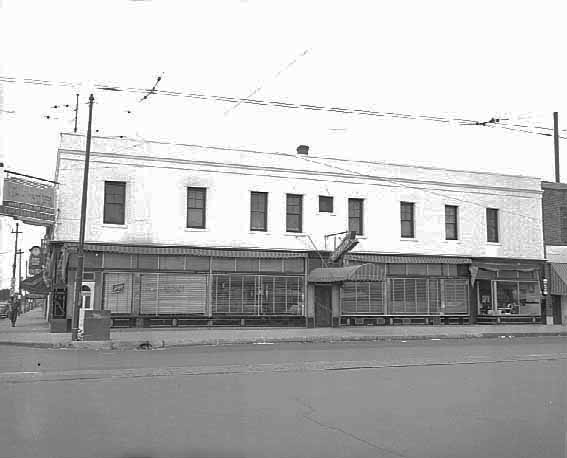
The Snelling side. August 1948 photo courtesy Minnesota Historical Society
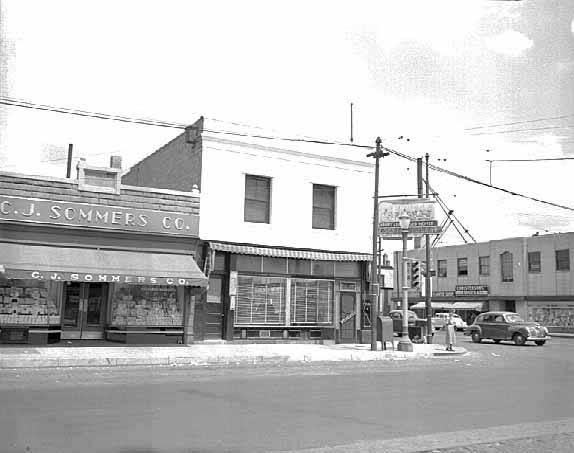
The University side. Photo also dated August 1948, courtesy Minnesota Historical Society
In 1959, Lindy’s Steakhouse was established in the basement. The only thing on the menu was sirloin steak – your only choice was what size you wanted.
SUBSEQUENT BUSINESSES
A search of the address shows that the cafe probably went out of business in about 1962. It’s a big building, so it may have been divided into several businesses.
In September 1962 the building became the home of the Foam Furniture Center.
In April 1968 it was the Wig Warehouse.
In January 1969 it was Ron’s Beauty Salon.
In November 1973 it became the Midway Branch of First Federal Savings and Loan, which then became Midwest Federal.
The contents of Midwest Federal were auctioned off on May 24, 1991.
The site is now a CVS Drug Store. As it began.
Please see Nando’s Hideaway.
This is the story of 718 Sixth Ave. No. and the many night clubs that inhabited the building.
EARLY BUILDING HISTORY
In 1906, a store formerly located at 701 Sixth Ave. N was moved on the property. It was moved off the property in 1910.
In 1910, a 24’ by 80’ frame movie theater was built on the site.
In 1918, the theater was altered and made into an auto shop.
Sometime between 1918 and 1922, that building was demolished.
In December 1921, a 25’ by 90’ brick store was built. An identical addition was built two weeks later; presumably the second story.
On March 31, 1922, a group of black citizens presented a petition to the City Council asking for the right to open a theater at 718 for the exclusive use of blacks. A counter petition was filed by property owners claiming that an exclusive theater was not needed.
THE SOCIAL INN
In August 1922, the building hosted the Social Inn. The Social Inn was owned by Andrew J. Claughton and Lee R. Wheeler, with James Ellis, Manager.
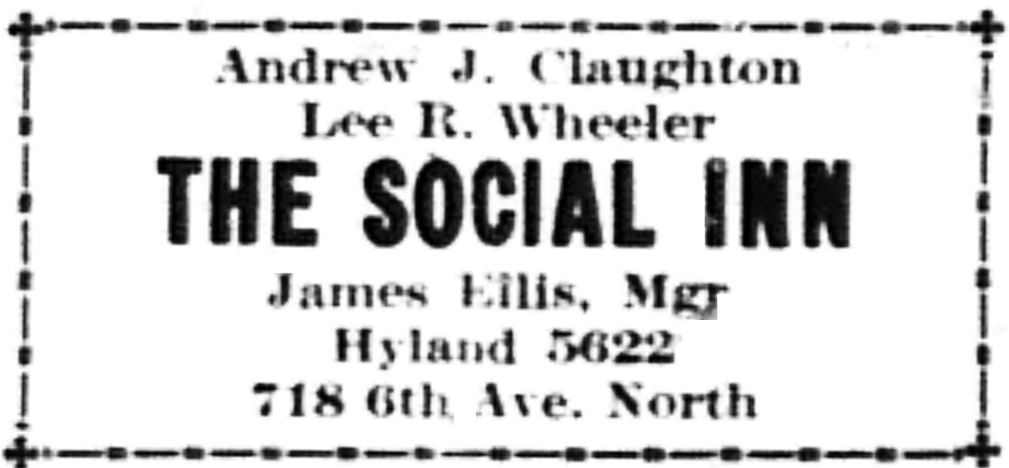
Northwest Bulletin, August 5, 1922
Did it move to 418 Sixth Ave No. by December 1922, or was that a typo?
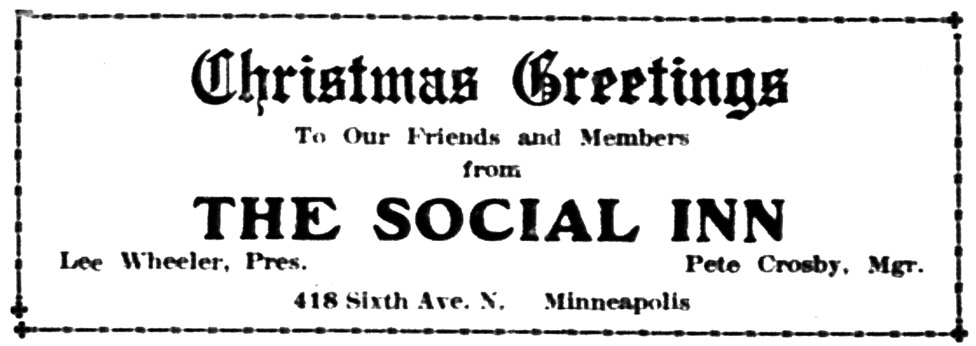
Northwest Bulletin, December 1922
Permit card entries describe the building as a store through 1923.
In October 1923, the building was the home of the Northwestern Waiters’ Club. A scandal appeared when policemen were accused of drunkenness and tipping members of the club off of an upcoming raid.
In November 1923, a man named H.M. Robe was given 30 days in the workhouse for running a gambling house in the building.
In October 1924 – 1930, the building was the headquarters for the Northwestern Porters and Waiters’ Club, “a Negro rendezvous.” The Club was in the news in 1924 because a crap game had ended in gunfire.
An article dated July 18, 1925, reported that the Union Co-operative Bakery would open in the building on that date. The Permit card bears that out.
THE COTTON CLUB
Named after the famous Cotton Club in New York, this Cotton Club was on Sixth Ave. No. in Minneapolis – not to be confused with the Cotton Club in St. Louis Park, or the Cotton Club in St. Paul. This was the most famous, for its placement “On the Avenue,” and for its infamous deadly shooting in 1928.
The Cotton Club was a “Chicken Shack.” Chicken shacks were common during Prohibition and this one had chicken and dancing and fighting all night. A newspaper account reported that the Cotton Club was operated by William Pugh, “a Negro.” It is unclear when the Cotton Club opened. It was one of many “Black and Tan” clubs on “The Avenue” that featured entertainment, late nights, gambling, and illegal spirits (or at least setups for your own).
THE SHOOTING AT THE COTTON CLUB
The following account comes from several sources: contemporary newspaper accounts, research by Jeff Neuberger, and a contemporary account by the Police Officers Federation of Minneapolis:
On February 3, 1928, at about 4 am, Jack Sackter, riding in a taxi, flagged down two Minneapolis Police Officers. James H. Trepanier, age 32, had been a patrolman for five years. He had been cited for bravery in the capture of a bandit in 1924. He had served as a motorcycle policemen prior to his transfer to the North Side precinct.
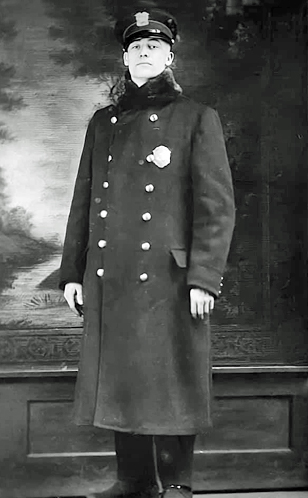
Patrolman James Trepanier. Photo courtesy Hennepin County Library, via Jeff Neuberger; touch up by Davidson Digitals
Patrolman Bernard Wynne, age 39, was a World War hero. He had been wounded in a gunfight two years earlier in which Minneapolis Police Sergeant Michael Lawrence was killed, and Wynne had been shot three times in the legs.
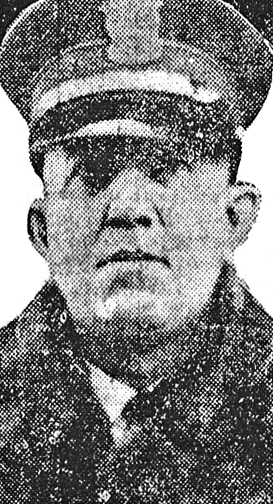
Patrolman Bernard Wynne. Photo from Minneapolis Star via Jeff Neuberger.
Sackter told the officers he had been assaulted by a group of men in the Cotton Club. There were two versions of what caused Sackter to bring the police to the club. Sackter maintained he was friends with Valencia Nay, one of the entertainers at the club, and as he spoke to her at his table, the notorious bootlegger Isadore Blumenfeld (aka “Kid Cann,” erroneously identified as his brother Harry Bloom in police and news reports) told Sackter to leave her alone.
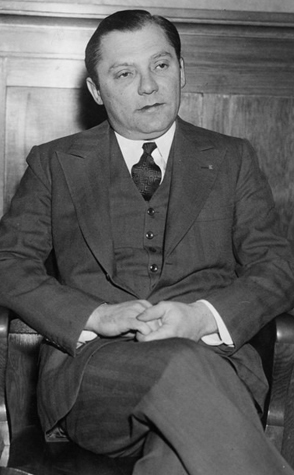
Kid Cann. Photo courtesy Minnesota Historical Society
Another man in Cann’s party, Verne Miller, struck Sackter with a gun. Miller, a former Sheriff from Beadle County, South Dakota, had become a bootlegger, bank robber, and embezzler, and had quite a bit of money on him. The second version is that Sackter said something very offensive to Ms. Nay and Miller hit him for insulting her.
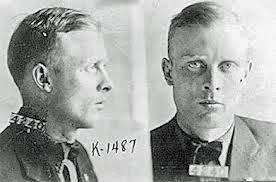
Verne C. Miller. Google photo courtesy Jeff Neuberger
WHAT HAPPENED?
The following is a contemporary account of what happened, from the Police Officers Federation of Minneapolis:
Patrolmen Trepanier and Wynne walked into the cabaret, drew their pistols, and commanded patrons of the cafe to line up to be searched for pistols.
“Call the wagon while I search them,” Officer Trepanier told Officer Wynne.
As Trepanier started to search the first patron in line and Wynne walked to the telephone, a table was overturned in one end of the cabaret. Five men were standing around the overturned table.
There was a tense moment while the two police and five men glared at each other. Then, with a sudden movement, one of the men drew a pistol and opened fire on the officers. In a second several other pistols were drawn in the crowd.
At the first shot, Officer Trepanier fell to the floor, severely wounded, and after two or three
more shots, Office Wynne staggered when a bullet struck his leg. Both patrolmen returned the fire.
For a moment pandemonium reigned. Pistols barked and filled the small hall with their roar.
Bullets thudded into the walls, splintered chairs and tables and broke out windows.
Women and men alike screamed, dodging, scurrying, and fighting to cover. Patrons turned over tables and cowered behind them, fear in their eyes.
Officer Trepanier, stretched on the floor, groaning from his wounds, braced his right arm
with his left hand and emptied his pistol at armed men in the place.
Officer Wynne only staggered when a bullet struck his leg. He emptied his pistol at the crowd and, despite the pain of his wound, brought them to order. Waving his empty pistol at the disordered mob, he commanded:
“Now all of you line up here and be quiet.” He called the patrol wagon and loaded the thirty remaining patrons of the cabaret into it, directing that they be taken to police headquarters.
At headquarters, all but eight were released. These eight were lodged in jail and questioned after three pistols were seized from them.
Detectives and gun squads were sent out through the city seeking other persons believed to have escaped during the gunfight. On a tip from a man whose car was found standing in front of the cabaret, detectives were sent to St. Paul in search of three men believed to have been companions of the man said to have started the shooting.
AFTERMATH
Officer Trepanier was the most seriously injured. Miller’s bullet had struck him in the right side of the abdomen, ripped a 3-inch laceration in the liver, tore off the top of the gall bladder, lacerated the stomach, severed the duodenum, smashed through the right kidney, and hit the fourth lumbar vertebrae, producing a hemorrhage in the spinal cord and stopped just under the skin on the left side. More than a dozen police officers lined up to give blood to save his life. Officer Trepanier was in the hospital numerous times. After he had partially recovered, he opened a jewelry store at Lake Street and Chicago Ave. South, but soon afterward went back to the hospital. Later, he moved his jewelry repair bench to Veterans’ Hospital where he designed and made jewelry and repaired watches when able to sit up. He waged a ten-year fight against his paralysis, but he had grown steadily worse for more than a year, and finally succumbed on September 20, 1938, at the U.S. Veterans’ Hospital. He was 42 years old when he died. He was survived by his wife and two daughters.
On May 15, 1938, Officer Bernard Wynne came home after assisting at a double drowning in the Mississippi River at 51st and Lyndale North and committed suicide.
The Grand Jury indicted Miller, Blumenfeld, Robert Kennedy, and R.L. Lawler on first degree assault charges.
Verne Miller was never apprehended for the shooting of the two officers, despite a manhunt with 1,500 fliers distributed, mostly over the Northwest. Verne Miller would be found murdered by other gangsters outside of Detroit on November 28, 1933.
One of Wynne’s shots hit Kid Cann in the thigh as he ran for the door. Kid Cann was taken to General hospital, as were the two police officers. Kid Cann was held without charge for days and then held for trial, accused of participating in the gunfight, but in October 1928, Hennepin County Attorney Floyd B. Olson dropped the prosecution, citing the differing stories about the relationship between Sackter and Nay.
Kennedy and Lawler were not captured until late April. One was a Sioux Falls, South Dakota, fight manager and one was a former St. Paul barkeeper.
ABOUT VALENCIA NAY
Ever the intrepid historian with insatiable curiosity, Jeff Neuberger dug deeper into the story of the cause of the ruckus, Ms. Valencia Nay. I considered doing this myself, so I’m glad he beat me to it!
News stories at the time list her as living at 538 James Ave. N. Checking records, he also found a Hurl Nay at that address. The Nay family was originally from Missouri: Hurl, his twin brother Harry, their older brother Lawrence, and Lawrence’s wife Gladys. Valencia may have either been a sister or Hurl’s wife. They were one of many acts that performed a musical comedy called “Shufflin’ Sam from Alabam” that toured all over the country. The show included the Creole Chorus, a group of female singers, and the Memphis Blue Demons Jazz band. There were also dancers doing the Charleston or the Black Bottom. People came to see the show for the comedy, the music, and the pretty girls.
Unfortunately, the Nays met a bad end. On March 15, 1934, while driving home from a performance at the Heidelberg Club in Flint, Michigan, about 2:15 am, the Nay brothers’ car was struck by a Great Western train. Lawrence, Gladys, Hurl, and Harry were killed. A Gipsie Nay was injured, as was Minnie Smith, 19. There was no mention of Valencia.
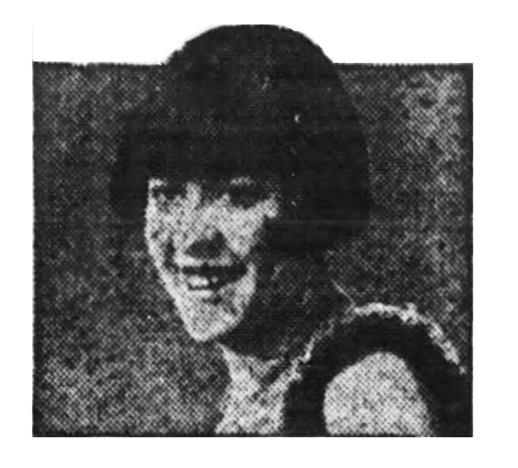
Not Valencia, but Gladys Nay, from the New York Age, September 15, 1928. Courtesy Jeff Neuberger
CHANGES
As a result of the shooting:
- Police Chief Frank W. Brunskill ordered that “entertainments in cafes and night clubs be brought to a close at midnight hereafter.” The order applied across the city, not just on 6th Ave. No. where “a number of all-night restaurants operate.” “Many of the eating establishments cater to a night trade a no hour for their closing can be set, Captain Nick Smith of the North side explained. But singing, dancing and the like will have to stop at midnight, according to the order.”
- Brunskill ordered the Cotton Club establishment closed and declared his intentions to close every similar place in Minneapolis. Meanwhile, every cabaret in the city was under police observation.
- On April 17, 1928, the City Council revoked the license of Horace Pierson, first floor of 718 Sixth Ave. N, formerly known as the Cotton Club. Presumably this was his restaurant and dance hall license.
- A City Alderman proposed an ordinance requiring that curtains and screens be removed from all chicken shacks, so as to permit a view of the interiors from the street.
PANAMA CAFE
April 1928: Serving chicken, Chinese food, entertainment. Presenting Warren & Ellison, direct from Plantation Cafe, Chicago. Best Music in Town.
MAX FELD, GROCERIES:
Evidence of Feld’s grocery store at this location can be found from December 1928 to June 1932. Feld moved his store around to many locations in the area during this time. In the 1932 Minneapolis directory, Feld is listed as a grocer and the second floor is listed as vacant.
CLUB KONGO
Beer became legal on April 7, 1933, and the Club Kongo opened on April 30, 1933. Kay Worcuff was listed on the ad below as the manager, with Bill Pugh as the M.C. Same William Pugh who was the operator of the Cotton Club? The movie “King Kong” was released just about the same time, inspiring the theme for this “Nite Club.”
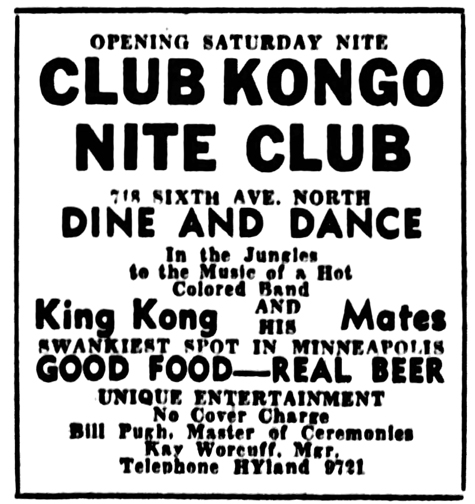
Minneapolis Tribune, April 1933
The presence of Rook Ganz meant this was a going concern!
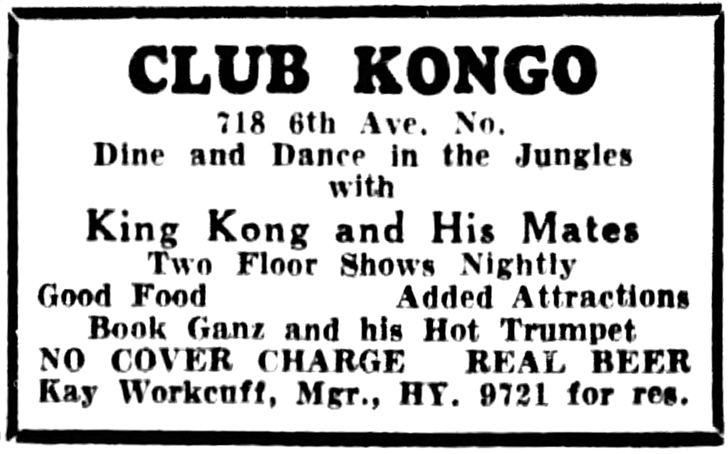
Minneapolis Star, May 5, 1933
But on a raid on a number of night clubs on January 14, 1934, proprietess Thera Rutherford was arrested for violating the tavern closing ordinance. She was fined $50 for staying open after 2 am, and her beer license was revoked on April 4, 1934.
CLUB MOROCCO
The Club Kongo was followed by another African-themed club called Club Morocco. The Grand Opening was on September 15, 1934. “Hotsy Totsy!” Music by the Club Morocco Band, the Northwest’s Favorite Night Club Entertainers. Another Grand Opening announced for December 13, 1934. The owner was Hamlet “Kid” Rowe, according to the ad below.
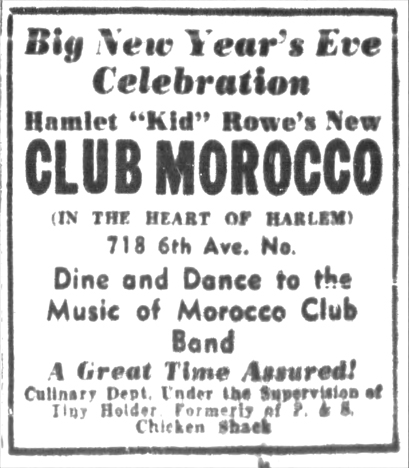
Minneapolis Tribune, December 31, 1934
According to the ad above, the cook was Tiny Holder, formerly of the P&S Chicken Shack. After the Club Morocco was gone, Tiny went back to the P&S:
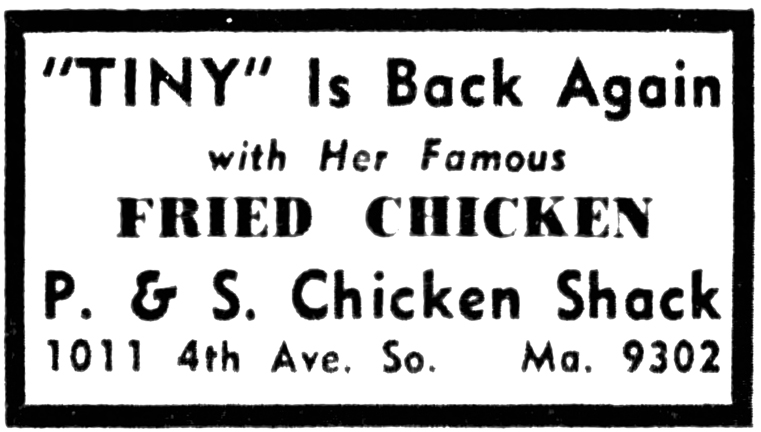
Minneapolis Tribune, June 8, 1940
END OF 718 SIXTH AVE. NORTH
The north side of Sixth Ave. No. was demolished in 1938 for the Sumner Field public housing project. The demolition permit for 718 Sixth Ave. North, with the Club Morocco sign still in the window, was dated September 15, 1938.
The following are a few photos showing the building in various stages before demolition. The first one is unfortunately undated but must be in the early days of the project since the buildings on either side are still there. Thank you to Jeff Neuberger and Alan Slacter for these images.
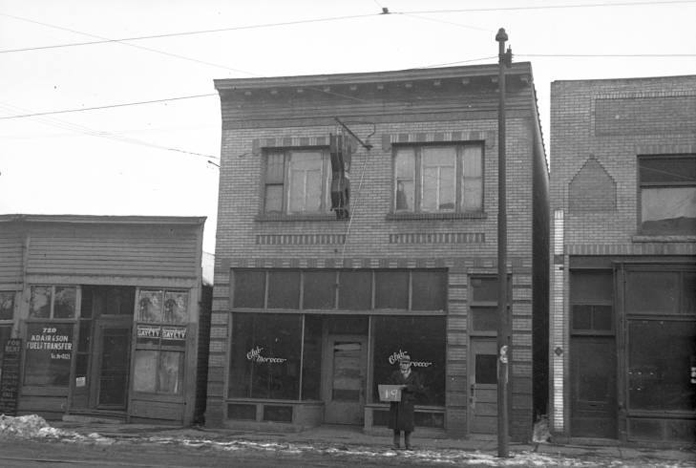
Photo courtesy Hennepin County Library
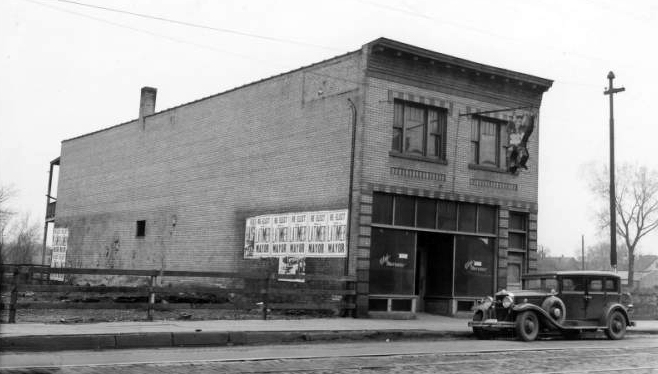
May 1, 1937. Photo courtesy Hennepin County Library
We wondered what was on that sign that was hanging from the pole on the second floor, but the photo I had was too low resolution to see it clearly. But then we found the original on the Hennepin County Library website, and discovered that it was a gorilla, hanging from the pole, left over from the Club Kongo days back in 1933-1934. What a find! Here’s a close-up.
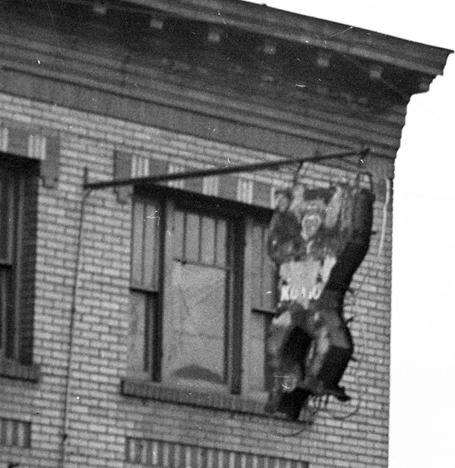
Hennepin County Library
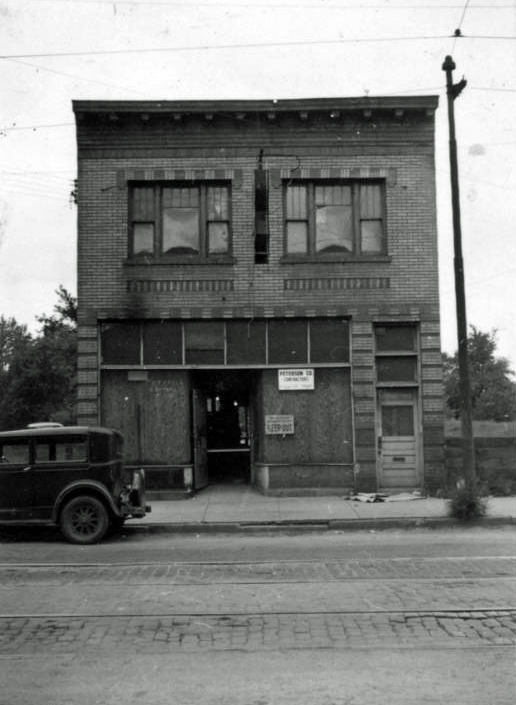
1938 photo courtesy Hennepin County Library
There is a note on the array of photos taken in 1938 that may indicate that 718 was the last building to be demolished on the north side of the street. Below is a photo of that sad day, September 16, 1938:
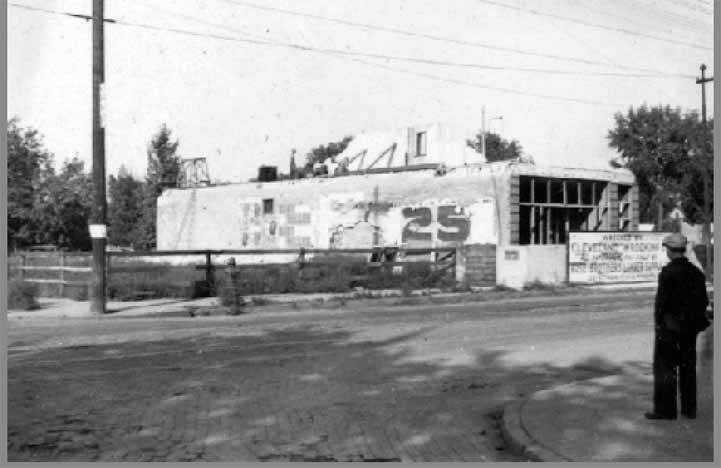
Photo courtesy Hennepin County Library via Alan Slacter
Of the many Cotton Clubs in town, this one was perhaps the most obscure and shortest lived. It was in the Kistler Building on Sixth Ave. No. for a very short time – please see the page on the Kistler Building for more information.
In a 1960 article in Select, Leigh Kamman says that Lester Young “spent many nights blowing in the Cotton Club at White Bear.”
Well, this record surfaced, and so we tried to find the Country Lounge.
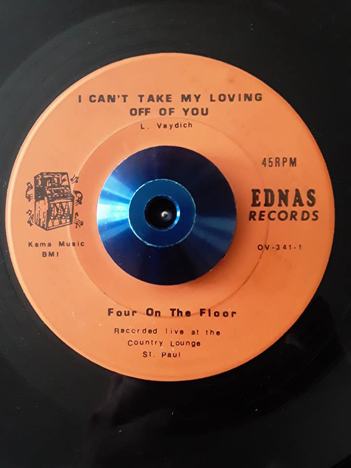
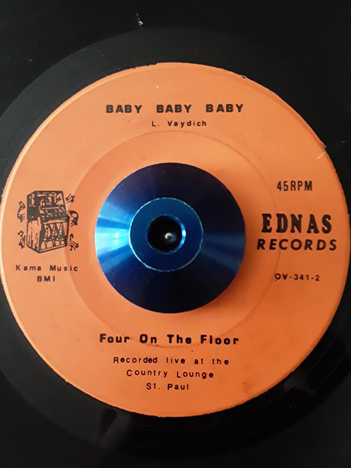
No success in finding the folks who made the record. One side is on YouTube, and is quite a delight!
There is an establishment called the Country Lounge located at 3590 Hoffman Road in White Bear Lake, which was built in 1965. Whether that was the one on the record – who knows? In 2020, the proprietors say it is not a music venue.
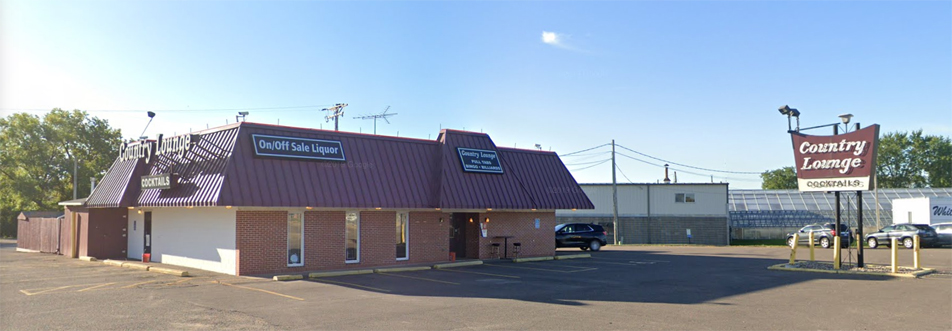
Google Image
Thanks to all the folks on the Old St. Paul Facebook page for their help! Please contact me if you have any answers to these burning questions!
There were two Covered Wagons, one each in Minneapolis and St. Paul.
The Minneapolis Covered Wagon was located at 114 So. 4th St. at Marquette.
1933
The Covered Wagon opened in 1933 – the end of Prohibition and a popular time to start a cafe. The Minnegasco pamphlet below says that the place originally opened two doors north of the 114 4th Street site.
The obituary of James P. Ryan named him as Vice-President of the restaurant from when it opened in 1933 until it closed in 1957.
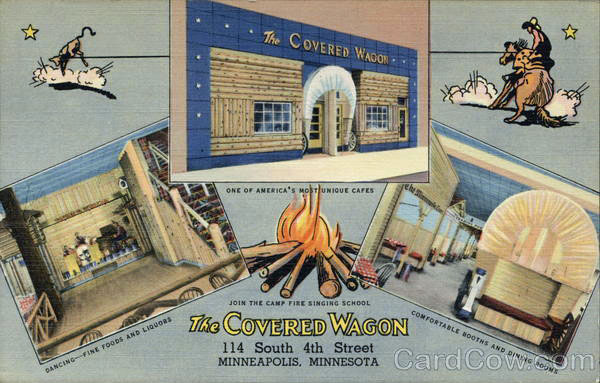
1943
The photo below appeared in Life Magazine on April 5, 1943. The caption read:
From old frontier days came the inspiration for the delightful Covered Wagon Cafe in Minneapolis, Minnesota. Historic guns and pioneer relics adorn the walls, and the booths along the side are designed to resemble such old-time Western institutions as the post office, sheriff’s office and the trading store. The Covered Wagon is also famous for its fine steaks – which are served, of course, with Heinz 57 Beefsteak Sauce, Worcestershire Sauce, Chili Sauce and other of Heinz wonder-working keystone-labeled condiments.
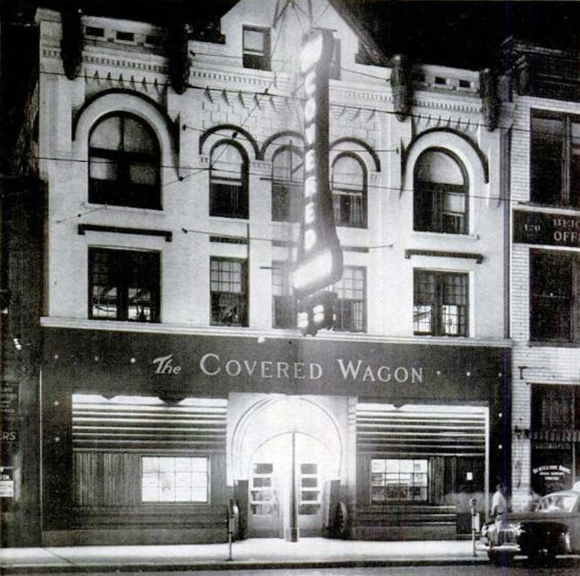
Just noticed that this is a Heinz ad! Nevertheless, nice picture.
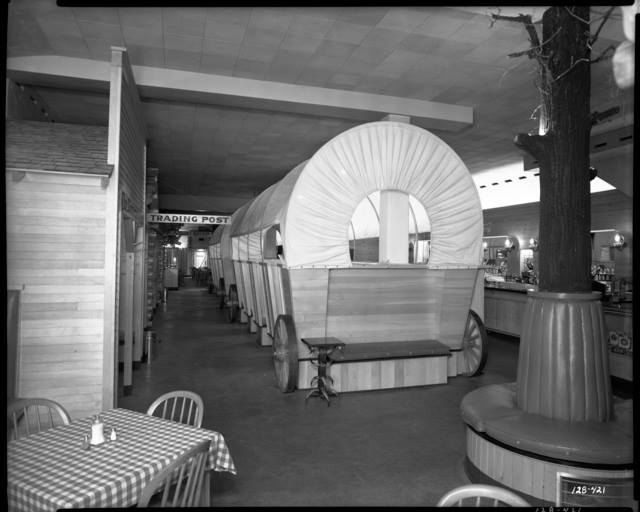
1943 photo courtesy Minnesota Historical Society
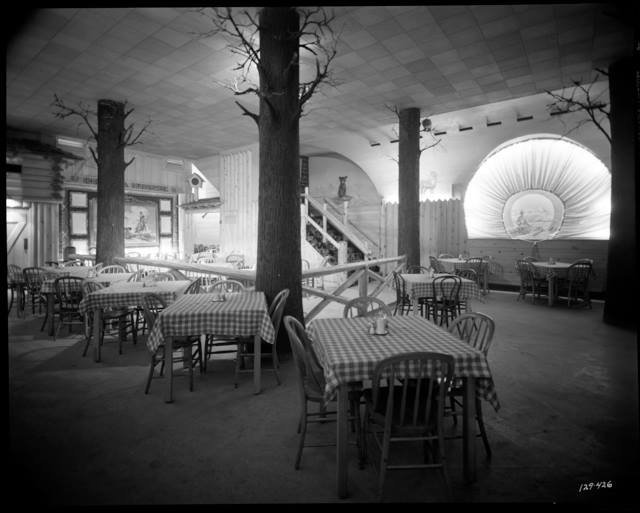
1943 photo courtesy Minnesota Historical Society
1950
Hugo Benson was named as the proprietor in 1950. A gossip column in 1958 said that his name was Hugo (Benny) Benson, and that he was a former co-owner.
1953
In October 1953, BeBe Shopp, Miss Hopkins and Miss America 1948, made Barbara Flanagan’s column when she made her home town first stand at the Covered Wagon. BeBe’s instrument was the vibraharp. (Minneapolis Tribune, October 13, 1953)
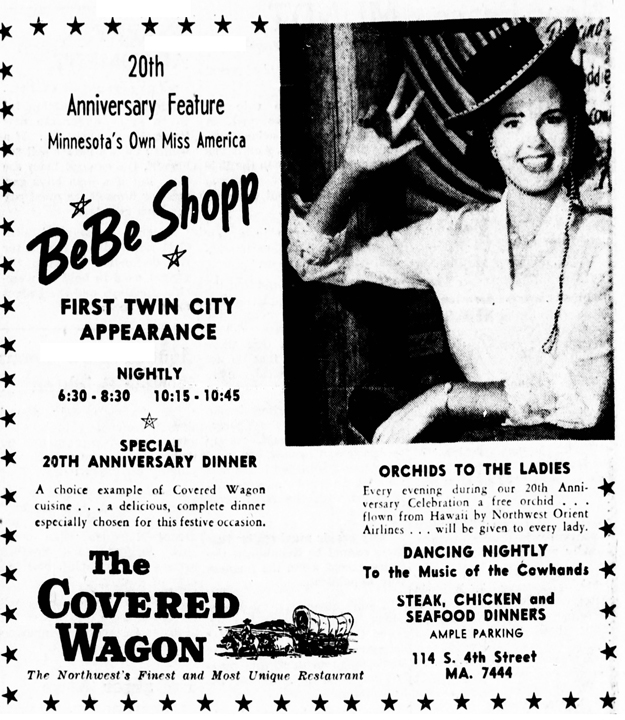
Minneapolis Star, October 15, 1953
The caption on the photo below reads:
A small part of the Main Dining Room. Here you will find that real western hospitality that has made the Covered Wagon the Northwest’s favorite for twenty years.
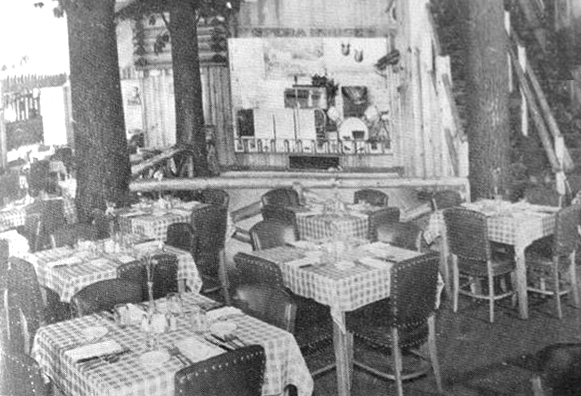
Photo from 20th Anniversary Menu, 1953
The photo below, perhaps from the same menu, shows the staff in cowboy hats, natch.
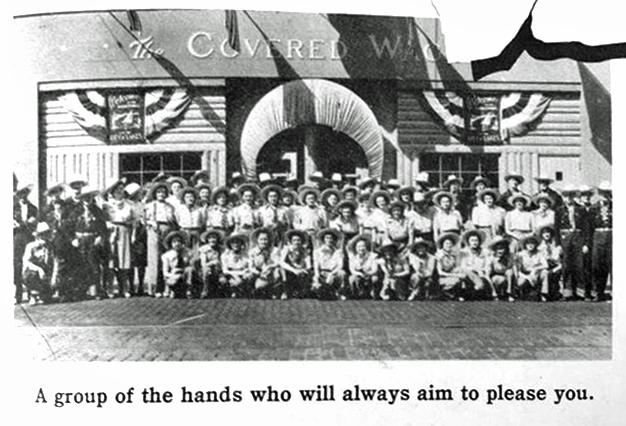
A Minnegasco cookbook from 1953 touts the Covered Wagon’s 20th anniversary. On the menu were Mallard Duck, Ring Neck Pheasant, and Hungarian Partridge, but you had to call ahead in the morning so they could go out and shoot it, I guess.
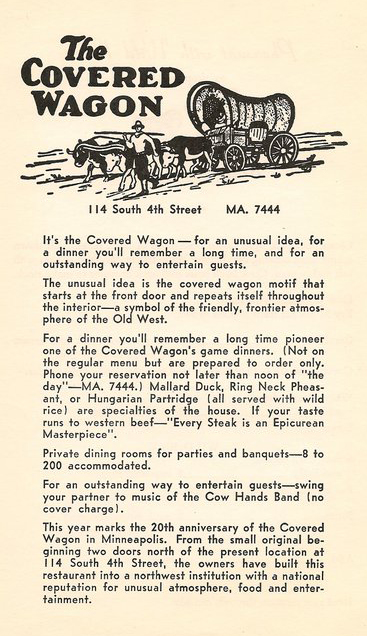
1956
In 1956, music was provided by Loren McNabb and his band on the “Largest and Finest Dance Floor in Town.”
The ad below gives a different address: 34 S. 4th Street. Perhaps because of demolition in the area, patrons had to enter through a different door?
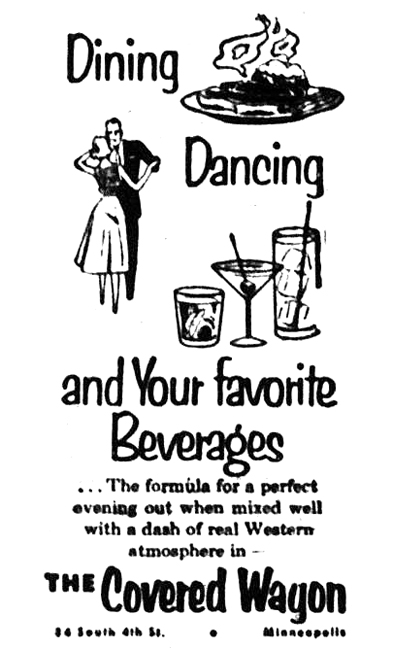
July 19, 1956, source unknown.
ARTIFACTS FROM THE WAGON
People seem to have a lot of souvenirs of the Covered Wagon, which is natural since it was around for almost 25 years. Here are some of them that have been shared, particularly on Facebook.
Ashtrays shaped like cowboy hats are irresistible! There were identical models for the St. Paul club as well.
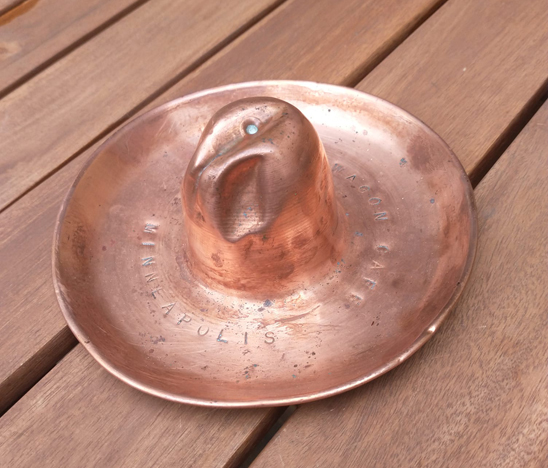
Photo courtesy Susan Schempf
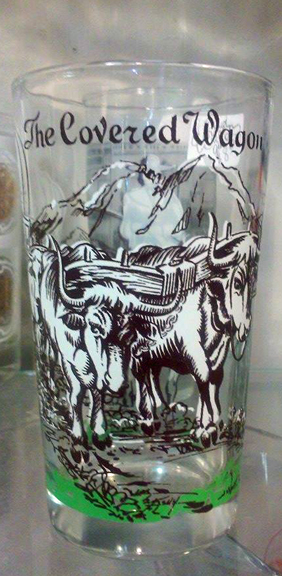
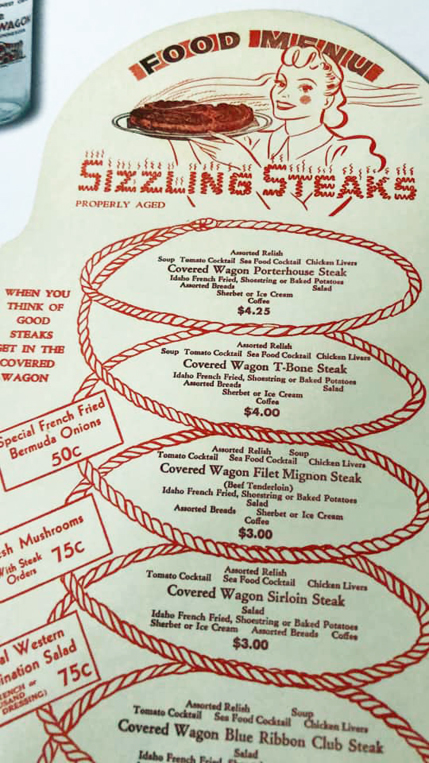
A menu of Steaks from Carolyn Lee Turner

A little spoon just begging to be slipped into a purse, courtesy Sherry Okeson Gross
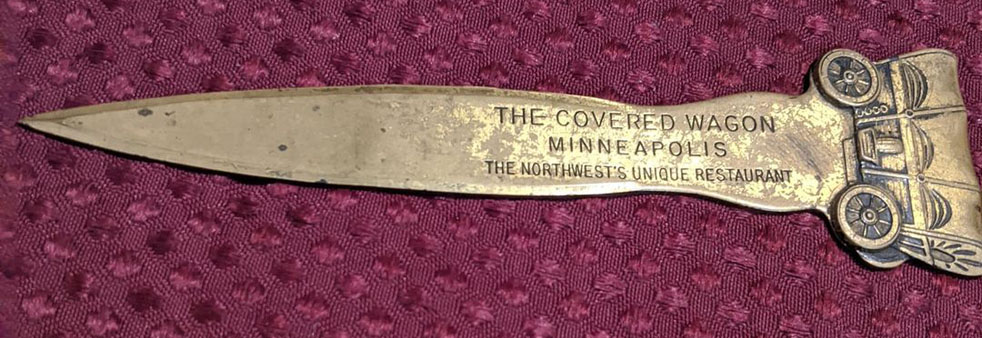
And a letter opener that seems a little sharper than necessary from Bob Jackson.
Below is a small iron skillet, made by the Lodge Cast Iron Co., says contributor Scott Hartgraves. The company made these small miniature skillets for various companies from the ’30s to the ’50s. The Covered Wagon would have bought the blank miniatures and applied their own decal for resale. Scott says they were usually more ornate than this.
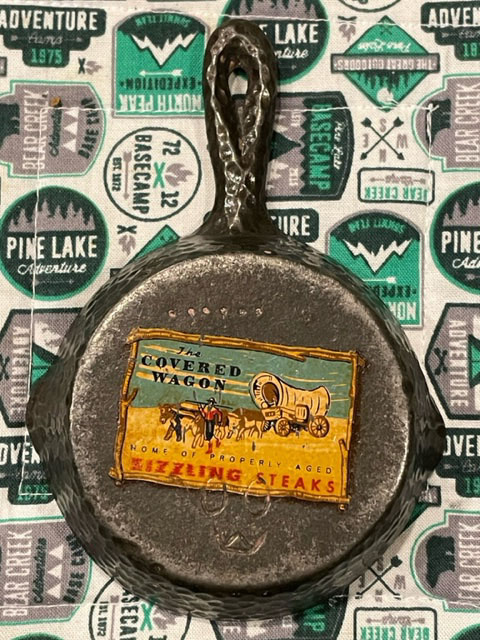
Image courtesy Scott Hartgraves
Music doesn’t seem to have been emphasized at the Covered Wagon – this was no Flame Cafe. Maybe people were too loaded down with steak to dance. The house entertainment was the Cow Hands Band, but they are mentioned on both the Minneapolis and St. Paul matchbooks, so maybe there were two of them.
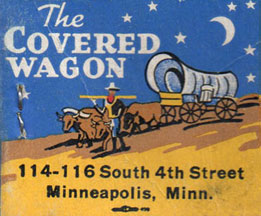
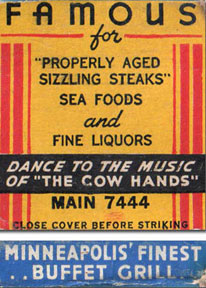
COVERED WAGON MOSEYS ON
In 1956, the Federal Government Services Agency condemned several buildings along Marquette for a new Federal courts building. The GSA offered the Covered Wagon $200,000 for its land, furnishings, and business. The owner, identified as Fritz Benson, countered that the business was worth almost half a million dollars, and a jury was brought in to inspect the building. The amount awarded came to $305,500. (Minneapolis Star, April 25, 1957)
The wrecking permit was taken out on December 1, 1958. The Hennepin County Courthouse, at 110 4th Street So., was built in 1960. The Covered Wagon’s liquor license was transferred to Rusciano’s.
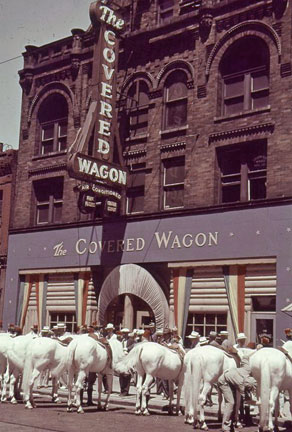
The End.
THE LITTLE WAGON
Kevin Flagstad reports that in 1957, new owners Bob and Olive Sorensen moved the restaurant to 420 South 4th Street and renamed it the Little Wagon.
There were Covered Wagons in Minneapolis and in St. Paul.
The St. Paul Covered Wagon was at 320 Wabasha Street. The 1943 ad that included both sites claimed “You Always Enjoy Yourself Here.”
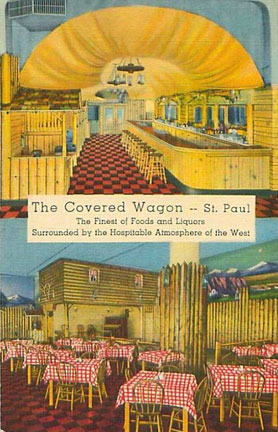
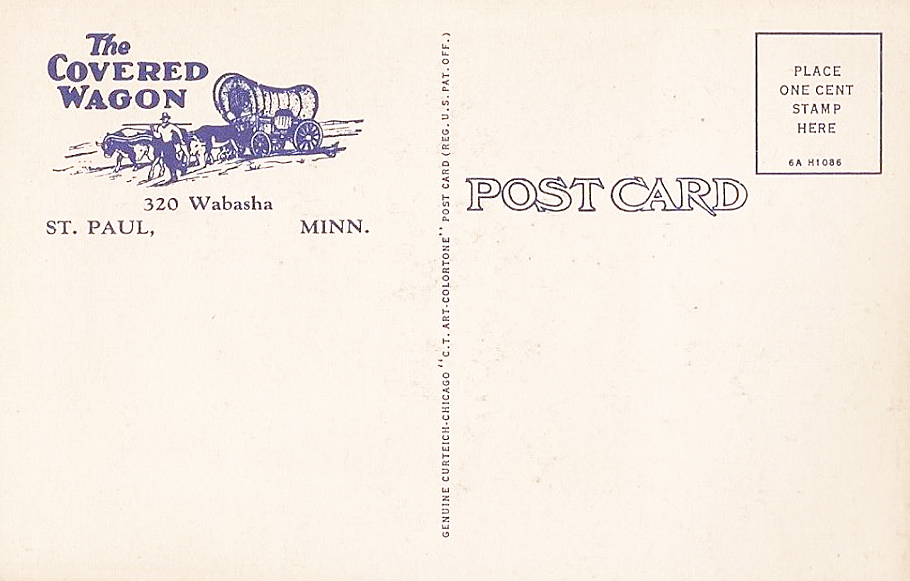
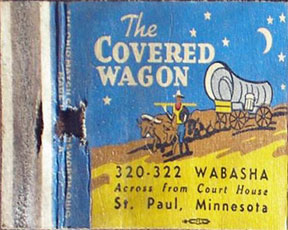
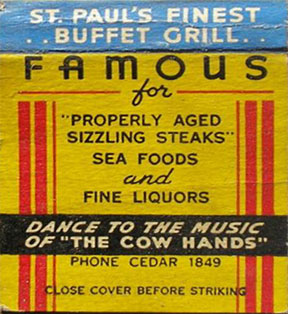
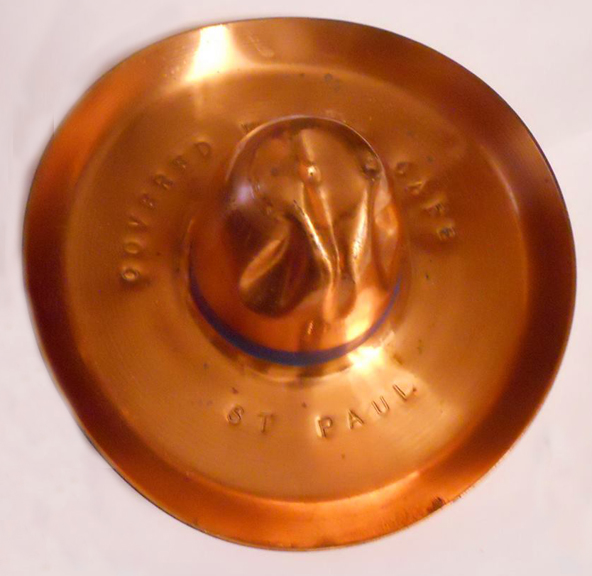
From the collection of Mark Youngblood
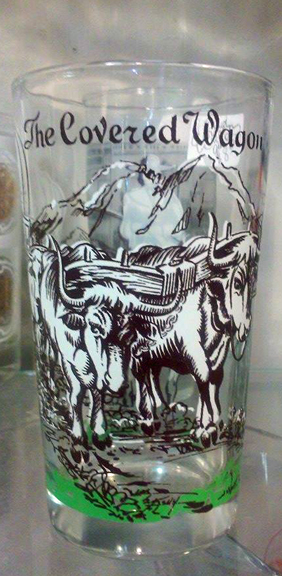
This page covers:
- The Cozy Bar and Lounge
- The Riverview Supper Club
- James T. “Jimmy” Fuller, Sr.
THE COZY BAR
The Cozy Bar and Lounge was located at 522 Plymouth Ave. No.
Building History
According to City permit cards, the 24′ by 72′ brick store building was built in 1898. It was apparently built as a saloon, as Henry H. Burfreind had a liquor license at this address going back to 1899. In 1910 it was affiliated with the Gluek Brewing Company, although it could have been from the start. In 1923 the place was closed down as an alleged saloon – Prohibition had gone into force in 1920 – so it became a candy store, as did every other bar in town. In 1932 it was a lunchroom serving hamburgers, and was for sale: “no competition,” claimed the ad. On April 18, 1933, H. Eckfdahl wasted no time getting a liquor license just days after Prohibition ended, again affiliated with Gluek Beer.
In 1935 it was the Red Dot Cafe; Martin William Malzakn was the proprietor and H.F. Barney held the liquor license.
In June 1948, Gluek made alterations to the Red Dot, selling off booths and tables.
THE COZY BAR
The first mention of the Cozy Bar found comes in October 1951; the operator was Gust Wills until at least February of 1954.
And although people don’t think of the Cozy or the North Side as a big polka spot, it was indeed, at least in 1957 to 1963. It was billed as “Minneapolis’s Hottest Polka Spot.” It was owned by polka bandleader Frank Pastuszak, who played the local ballrooms consistently throughout the ‘sixties.
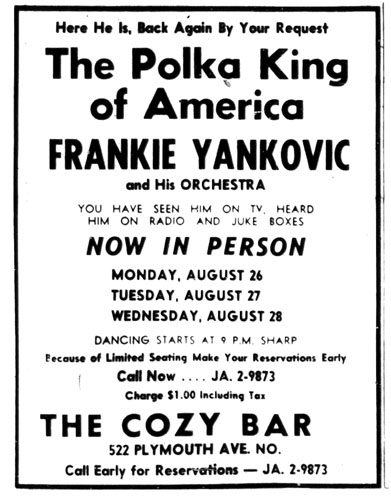
1957, North Hennepin Post
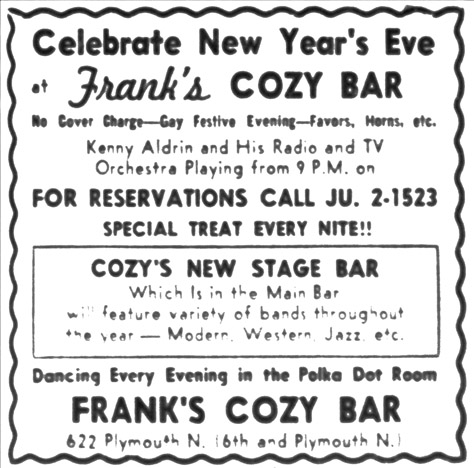
Minneapolis Tribune, December 27, 1959
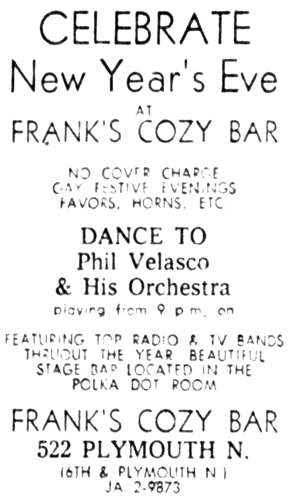
1960
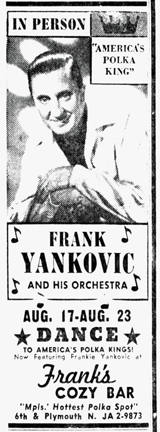
August 17, 1962
Frank held a mortgage burning party in February 1963 and played with his band the Polka Pals.
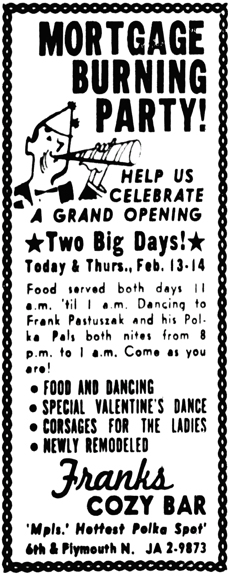
In 1963 the bar also sponsored a baseball team.
From 1965 to 1969 there seemed to be a couple shootings or robberies reported every year.
ENTER JAMES FULLER
At one point the Cozy Bar was purchased by James T. “Jimmy” Fuller, Sr. and his wife Margaret Fuller.
An ad from the Minneapolis Spokesman dated April 1967 calls it “Minneapolis’ Newest and Most Exciting Bar and Place of Entertainment. Live Music and Dancing Nightly.”
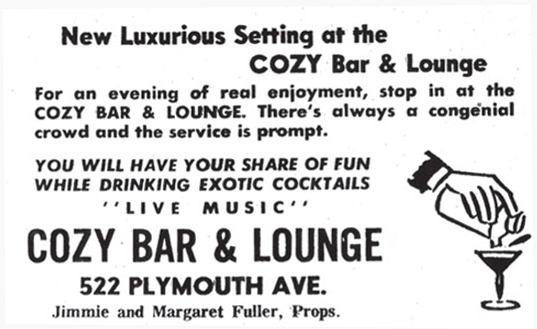
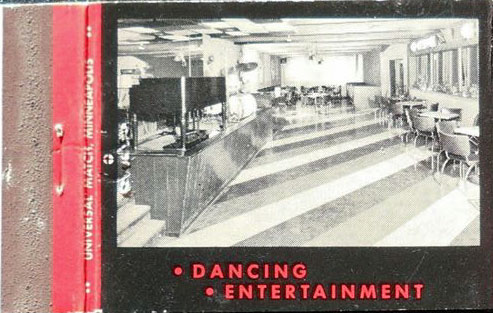
Matchbook images thanks to the Match King, Alan Freed
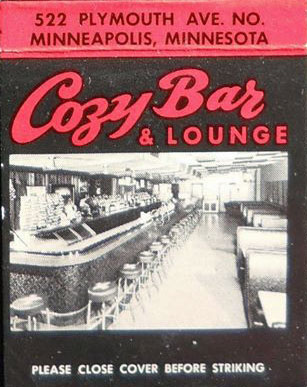
In the late ’60s it was a major venue for R&B acts (Mojo Buford was a frequent performer) and one of the few black-owned bars in Minneapolis. In 1968 and 1969 other frequent bands performing there were the Amazers and the Blazers.
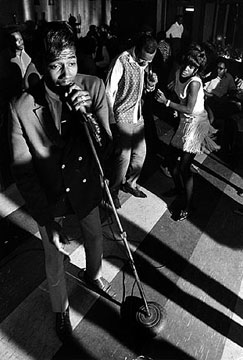
The Blazers performing at the Cozy in 1968. Photo by Mike Zerby, courtesy Minnesota Historical Society
In July 1972 the Cozy was one of at least three bars that was ordered to close by a group of 20-25 black youths, one reportedly carrying a high-powered rifle. Manager James Gibson said the youths told him to close down the bar and that if he didn’t “somebody would get hurt.” It turned out that the group wanted several black-owned bars to close down that night so patrons would attend a rally to protest the beating of a pregnant black woman at the Aquatennial parade. (Minneapolis Tribune, July 28, 1972)
Around that time the bar was raided by police at 2:30 am and customers were still there, in violation of the 1 am closing time law.
There continued to be shootings and robberies at the Cozy in the early ’70s.
The photos below of the bar in the late 1960s were provided to Secret Stash by James Fuller, Jr.
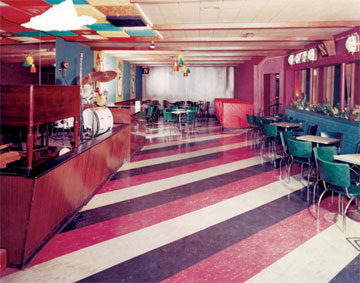
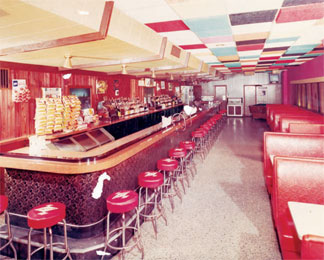
Below is a photograph of a photograph by famed African-American photographer Charles Chamblis , who took photos of North Minneapolis for decades. The quality isn’t good (I don’t know where the image came from), but it’s the best view I have of the outside of the building.
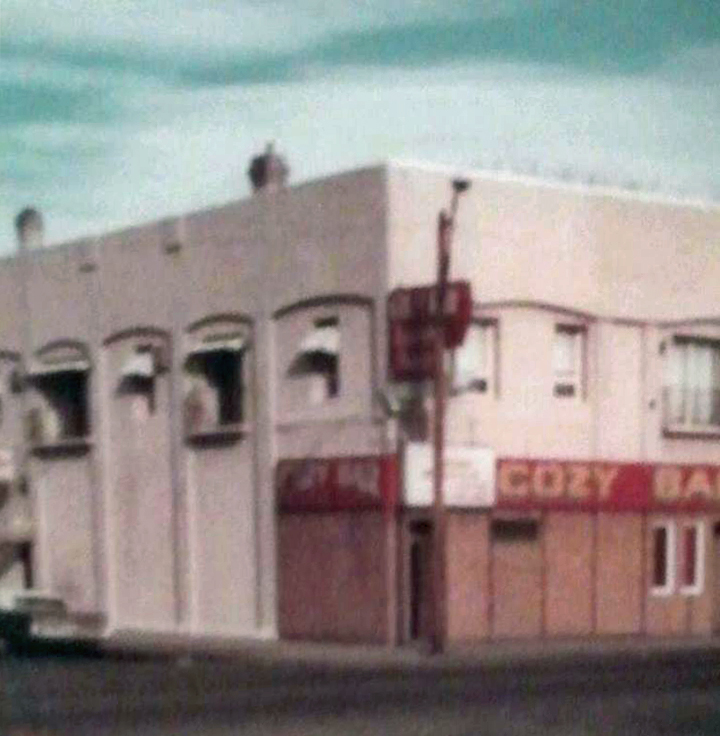
In March 1977, the building was condemned by Mn/DOT for the construction of I-94 through North Minneapolis.
RIVERVIEW SUPPER CLUB
Fuller sought to transfer his liquor license to a new club, the Riverview Supper Club, located at 2319 West River Road. The transfer was held up by City Alderman Richard Miller. When Miller was replaced on the Council by Patrick Daugherty, the new Alderman “sought reports from city officials on the impact the nightclub would have in the neighborhood and “when the reports came in in his favor, I couldn’t do anything to stop him.'” The transfer was finally approved on March 17, 1978.
The Riverview was built on three acres at the end of West River Road for about $750,000. The land had been the end of the tracks for train engines, and a huge concrete base of an old roundhouse had to be removed, which required two months of excavation. It was located in what was known as the North Washington Industrial Park. Boyd’s on the River and Broadway Pizza soon joined the Riverview in the area. (Minneapolis Star, May 9, 1980)
The building had 11,000 square feet of dining space in a low, square, otherwise nondescript building, with a spectacular view of the Mississippi River through a 50 ft. picture window. Areas of the facility included:
- A large, blue and tan dining room, decorated with river-themed paraphernalia and prints.
- A basement level banquet room.
- A private banquet room on the main floor.
- A bar near the kitchen that serves the seating terraces which face the stage and dance floor
- Another bar, quiet enough for conversation.
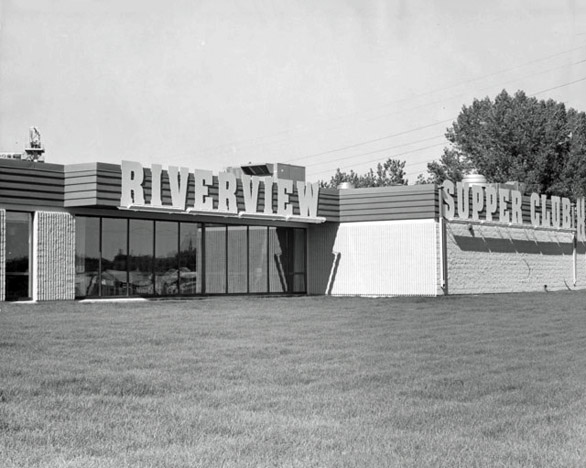
The Riverview, 1985. Photo courtesy Minnesota Historical Society
ENTERTAINMENT AT THE RIVERVIEW
Fuller designed the club to offer Vegas-style live music, and to make live jazz its drawing card. First Manager Bubbles Holloway said, “We intended to set this place up for listening and dance music, mostly jazz, and not to cater to the disco set, because we believe more people want that and because disco is going down.”
Although the Riverview Supper Club opened in early April, 1980, it had its official Grand Opening on May 10 and 11, 1980, with a show by Broadway star Melba Moore. Moore’s four shows brought in near capacity crowds, and reviewer Michael Anthony found that the facility had “more than adequate sound properties and sightlines.”
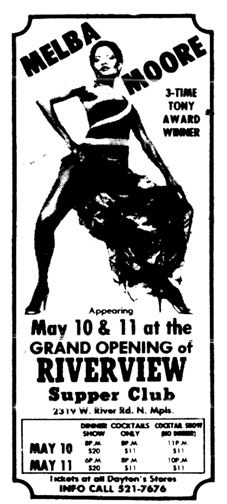
1980 Ad from Sweet Potato magazine
The venue offered jazz by Melvin Jordan and Jim Hamilton, and Roberta Davis.
Early name acts included:
1980
- Millie Jackson, July 5-6, 1980
- Stanley Turrentine, July 13-14, 1980
- Count Basie, December 16-17, 1980
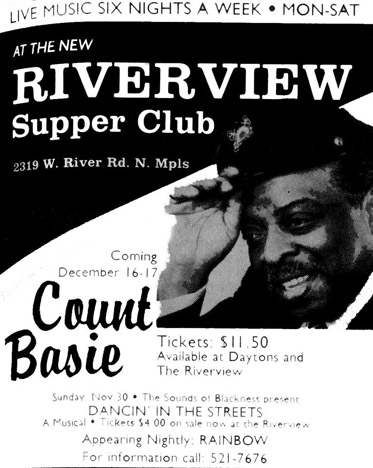
1980
1981
- B.B. King, February 25-26, 1981
- Herbie Mann, April 3-4, 1981
- Millie Jackson, April 12-13, 1981
- George Shearing, May 17-18, 1981
- Jazz Festival with Count Basie, August 19, 1981
- Gil Scott-Heron, October 19, 1981
- Doc Severinson, October 27, 1981
1982
- The Stylistics, January 14 – 16, 1982
- Bobby “Blue” Bland, February 14, 1982
- Arthur Prysock, April 8, 1982
- Stanley Turrentine, May 7 – 8, 1982
- Roy Ayers, May 29, 1982
- Patrice Rushen, June 15, 1982
- Bobby “Blue” Bland, September 4, 1982
- Evelyn King, December 14, 1982
The venue began to host boxing matches in about 1983.
After a seeming lull in national acts, they began to appear again in 1988.
- Chi-Lites, June 3, 1988
- Evelyn Champaign King, August 7, 1988
- Bobby Lyle, August 28, 1988
- Bobby “Blue” Bland, January 19, 1992
- Bobby Womack, March 6, 1994
In about February of 1999, the club began to feature comedians from BET’s Def Comedy Jam on Thursday nights.
By January 2000, most of the music was provided by DJs.
VIOLENCE DOGS THE RIVERVIEW
To the chagrin of owner James Fuller, Sr., his dream venue began to become a focus of violence.
On July 9, 1995, Bryan Evan Thomas was murdered in the parking lot of the Riverview from a gunshot wound to the neck. The suspect, Leon M. Perry, was chased and captured by Eric Lukes, an off-duty policeman. Perry was convicted of first-degree murder and sentenced to life in prison.
On March 23, 1996, robbery suspect Keith L. Jackson was shot and killed by an on-duty policeman in the parking lot of the Riverview.
On May 23, 1998, Gary D. Holmes was killed outside the club by a single gunshot to the back. He had been just outside the front doors and had staggered into the restaurant, where he died. There had been a “skirmish” in the parking lot, and Fuller thought that the killing was gang-related, but this was unconfirmed by police. “Enough is enough and violence of any kind will not be tolerated at our establishment,” said Fuller. (Minneapolis Tribune, May 24, 1998)
THE END COMES TO FULLER’S DREAM
James T. Fuller Sr. died at the age of 89 on December 27, 1999. The club’s management was taken over by his son James Fuller, Jr.
According to Secret Stash, James Fuller Jr. finally closed the bar after three of the club’s unarmed security guards were shot in the winter of 2000. The Riverview’s last day was December 10, 2000. It was torn down and the land was redeveloped into condos, appropriately named the Riverview.
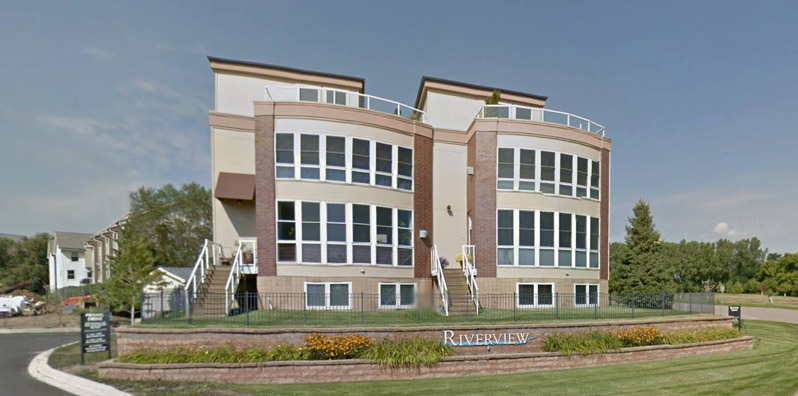
GoogleEarth photo
JAMES T. “JIMMY” FULLER, SR.
The man behind the Cozy Bar and the Riverview (and the Regal Tavern before that) was born in Roanoke, Virginia, the son of a coal miner. He attended Wilberforce University in Wilberforce, Ohio, where he met and married his wife Kathleen. James Fuller, Jr. was born in 1938.
The family moved to North Minneapolis, and Fuller worked in the machine shop of the Onan Corporation, where he and co-worker W. Harry Davis sang in the Onan Corporation’s men’s chorus.
Save
Save
Save
Although most people remember the Cozy Bar on Plymouth Ave. in Minneapolis, there was another Cozy Bar at 202 Concord (now Cesar Chavez Street) on the West Side of St. Paul (but not in the City of West St. Paul). I don’t know if it had live music.
By 1969 the proprietor was Herbert Howe. According to tales on Facebook, it was a fun but increasingly dangerous place; one report was that a body was found in a dumpster and a metal detector was installed to find guns and knives.
In 1978 there was a particularly upsetting incident when a customer got into an argument with two other patrons, left and came back with gun, shooting them and then pointing the gun at the bartender, who was the son of the owner. Young Howe killed the assailant with a rifle. The Ramsey County Grand Jury voted not to indict Howe. The patrons who were shot survived.
COZY CANTINA
In 1994 the bar, which had been renamed the Cozy Cantina, was owned by Herbert Howe, Jr. That January the bar’s license was suspended for two weeks when it was discovered that the bartender, a convicted felon, had access to two guns that were kept behind the bar. The gun accidentally discharged and wounded the unruly patron. The suspension was appealed and overturned. Herbie Howe was still the owner in 2002.
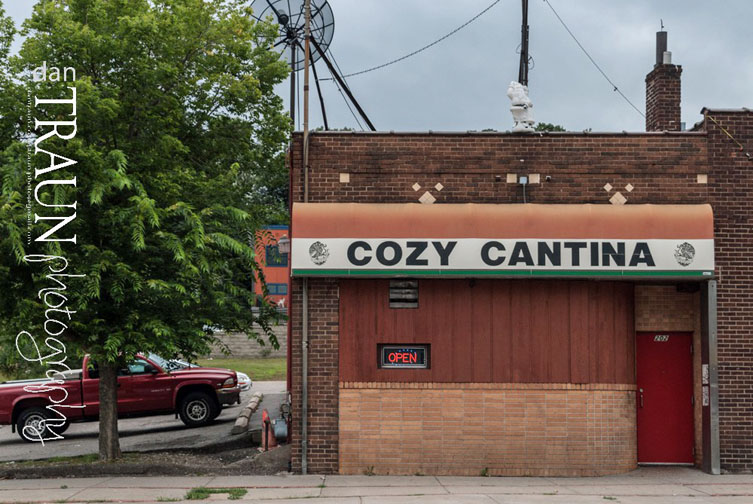
2014
The building at 5001 W. 80th Street (now American Blvd.) in Bloomington was built in 1970, according to county records. It is the Southgate Office Plaza, located at the southeast corner of the intersection of Highways 100 and 494. In that time, it has gone through a lot of changes.
DADDY’S
In 1976 the place was called Daddy’s (or Daddys’ Money). A review from that year lists the lobster dinner at $6.95 and the highest priced dinner at $7.50. Here’s what the reviewer said about the entertainment:
Speaking of waiters and waitresses, they’re only hired if they can sing, dance or play a musical instrument of one kind or another. That’s right. All evening long your entertainment is provided by one waiter or another (and occasionally, but not enough, the manager himself).
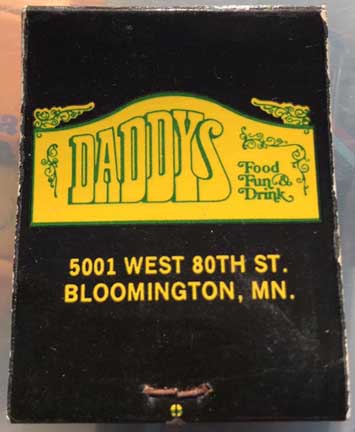
Courtesy Mark Youngblood
CRITERION
Another restaurant to occupy the space was the Criterion, presumably after Daddy’s, since the Criterion had to move from its original location in St. Paul because of a fire in March 1978. Although the popovers were just as good, many folks thought that it just wasn’t the same.
PURPLE ONION SPORTS BAR AND RESTAURANT
This shows up in August 1991, but apparently went bankrupt two months later.
BILLABONG AUSSIE GRILL AND PUB
Opened about August 1993, went bankrupt in November 2006
EL LORO MEXICAN RESTAURANT
The space is now the El Loro Mexican Restaurant, one of several in the Twin Cities.
The Criterion Cafe has a schizophrenic history at best – or maybe a case of multiple personalities. Sorting it out won’t be easy but I’ll give it a try.
The first mention of a Criterion Restaurant in St. Paul found in the Minneapolis papers was in the Tribune, June 25, 1885. Proprietors were listed as H. Nachtscheim and Holmes, and the address was 48 East Seventh Street. Later that year Holmes was gone and the restaurant advertised oysters quite enthusiastically.
On June 25, 1895, another Criterion was mentioned, this time at 246 Nicollet. Someone apparently wanted to burn this one down but was foiled. A few days later the firebugs were successful and two firemen died putting out a conflagration at the McDonald building on First Street in Minneapolis.
One man said that the restaurant opened in 1901 as a German restaurant by a man named Schwartz but I couldn’t find that.
The next mentions I found were wantads dated April 1908, for a porter and cook at the Criterion Cafe at 319 Hennepin Ave. in Minneapolis (Scandinavian preferred). That establishment opened on May 1, 1908.
After Prohibition ended, the Criterion emerges on November 2, 1934, at its traditional location at 739 University Ave. at Grotto in St. Paul.
In January 1945 the term “Club Criterion” comes into use at the St. Paul location.
Next we see ads for the New Club Criterion, re-opening in December 1945.
But what’s this about Harry’s? Seems Harry Doust, the former owner of Harry’s Cafe in Minneapolis, bought the Club Criterion in September 1947 and began using the name Harry’s for the Criterion, and even duplicated the menu. Harry Doust kept changing the name of the St. Paul restaurant:
- Harry’s Criterion
- Harry’s, Formerly Criterion
- Harry’s Cafe
- Harry’s
Thus we see the photo below, dated January 29, 1948, from the Minnesota Historical Society. What the hey? A lawsuit ensued, and in June 1948, Harry Doust was enjoined from using the name Harry’s. Funny thing was that Doust hadn’t been associated with the St. Paul Harry’s since February 1948. The new owner was Harry Carnes. Oy.
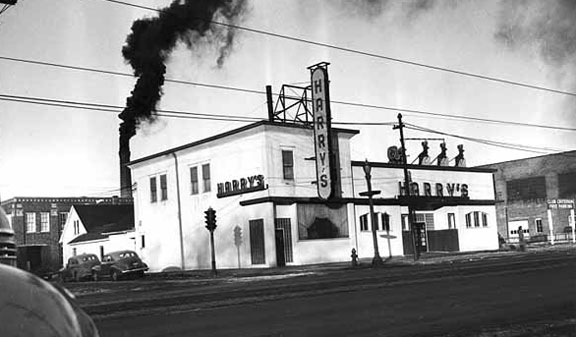
Oh no, it’s not over. In January 1950, Harry Doust bought back the Criterion from Harry Carnes. By July 1950 Doust was back at it, calling the cafe Harry Doust’s Criterion Cafe. At least his name was in small letters. But in June 1951, Harry’s name was definitely above the fold in this recipe/SuperValu ad. Tsk Tsk.
In September 1952 the madness was over when Harry Doust sold the Criterion to a group of investors for $100,000. Ralph W. Jacobs became General Manager – Jacobs had managed several properties, including Harry’s in Minneapolis. After unsuccessfully vying to start restaurants in the western suburbs, including the new Knollwood Shopping Center in St. Louis Park, Doust became connected with Sleizer’s when it was renamed Bowman’s. Doust died in March 1960.
RAY KROC
In 1957 McDonald’s owner Ray Kroc came to Minnesota with an idea to build a McDonald’s franchise in a cold-weather climate. The first franchise in Minnesota opened in September 1957 in Roseville. The second franchise was owned by Jim Zien, the owner of the Criterion. Kroc spent a lot of time at the Criterion and fell for the lovely organ player, Joan Smith. Kroc and Smith eventually married in 1969, and Smith’s ex-husband became a McDonald’s franchise holder in South Dakota.
From 1960 to 1969, Dick Clausen played organ and piano in the dining room.
Tom Marver provided this lovely memoir:
I grew up at the Criterion during the ’50s and ’60s. Besides their fantastic popovers, they were famous for their Criterion salad. The Criterion was owned by the Sandler family and Mickey was the parking lot attendant who could converse with you in Yiddish. When you would walk in the restaurant their was a lobster tank by the entrance. As a kid, I would sometimes sit on Joan’s lap when she played the organ (when she wasn’t at the piano in the bar) and that is how I learned to play my Hammond B-3 organ. The Criterion was much more than just a Saint Paul supper club, it was an institution. ❤️❤️
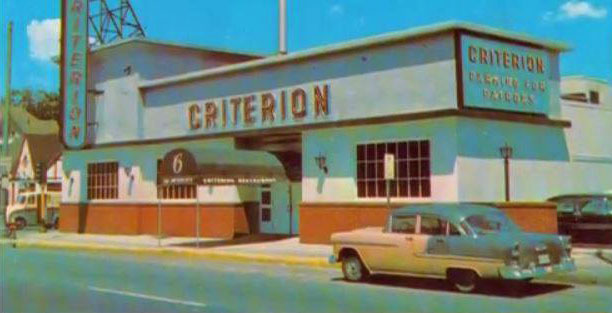
1955 Postcard courtesy Minnesota Historical Society
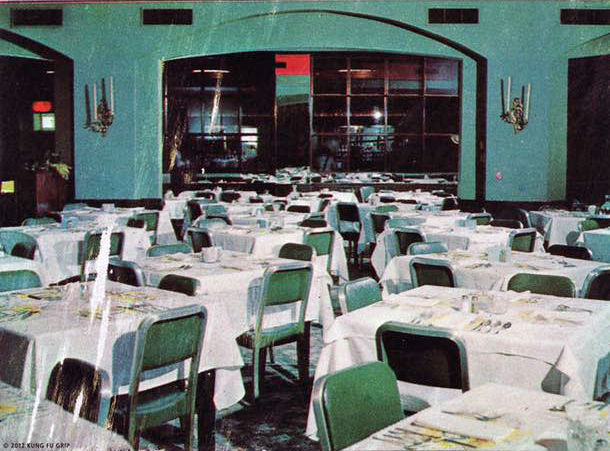
Matchbook posted on Facebook by Ron Ciccone
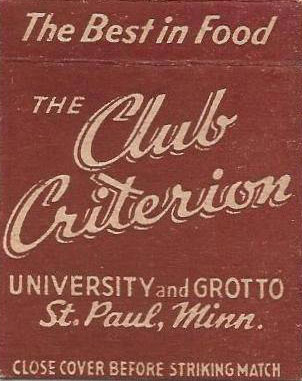
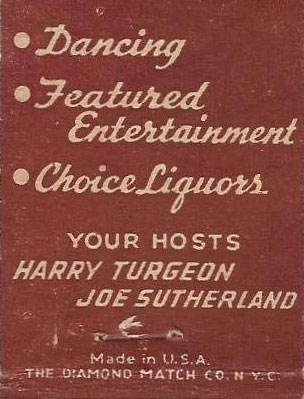
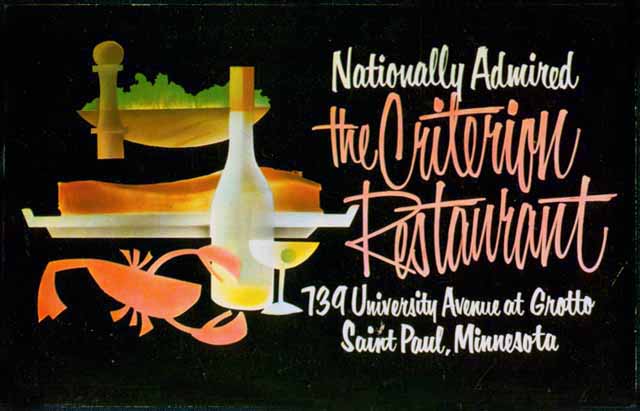
1960 ad courtesy Minnesota Historical Society
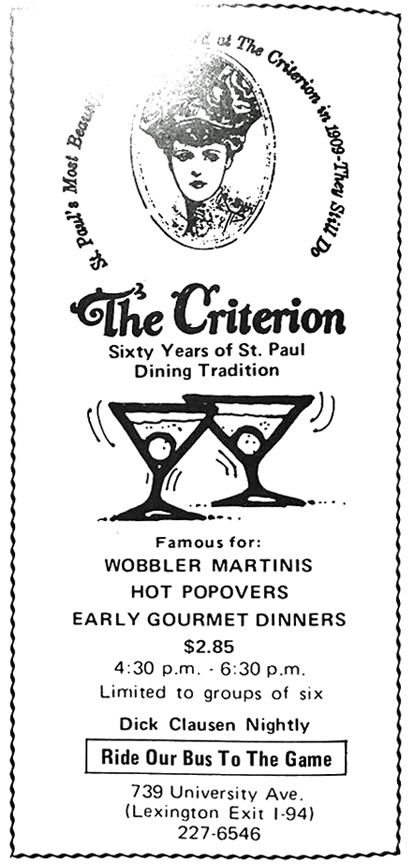
1973 ad courtesy Bob Murphy
END OF THE ST. PAUL CRITERION
The Criterion suffered a major fire on March 19, 1978, starting in the basement at about 3:48 pm. 65 firefighters fought the blaze – no one was injured. At the time the owner of the restaurant was Robert Sandler and his mother Bernice owned the building. They had owned and operated it since about 1962. The building suffered about $100,000 in damage. Sandler decided not to rebuild.
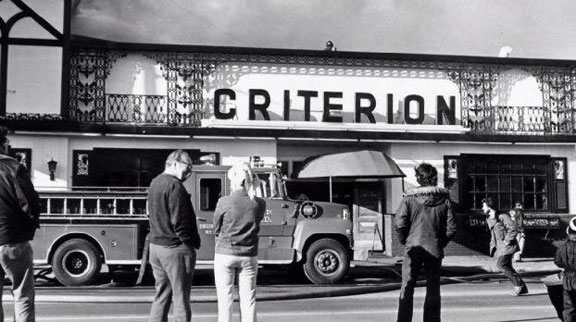
Photo of fire posted on Facebook by Rick Schlosser
The report of the fire revealed that “The Parlor” had seating for 220, and there were three private rooms that sat 90 people. One of these rooms had a private entrance from the outside that made meeting people not married to you more discreet.
Facebookers remember the lobster, crab, and especially the popovers that made it a special place.
BLOOMINGTON
Club Criterion
After the fire, the Criterion moved to the Southgate Office Plaza in Bloomington. Ads for staff started on July 30, 1978.
An auction was held on August 30, 1978, at the St. Paul site to liquidate any salable chairs, tables, chandeliers, etc.
Save
Save
Save
Save
Save
Save
Save
This venue was discovered through a photograph in the archives of the Minnesota Historical Society. It was described as taking place at the Crown Cafe, but there were several of them, so where was this?
To the rescue came Duane Jensen, who put together the following combination of memories of his father, whose first job was distributing flyers for the place, newspaper articles (not cited – probably from St. Paul papers that Duane researched), and court papers.
NICK CROWN
“Nick’s Crown Café” was named for Nick Crown and his wife Lillian. His friends called him Nick “the Greek” Crown and his son was known as “Little Nick.” Nick was of Greek heritage although he was born in South Africa. He came to Minneapolis and worked for his uncle in his candy store. One evening after the store closed, Nick returned and opened the basement safe removing the contents. He was soon caught because the safe was opened using the combination, known to only a few workers.
This was not his last exposure to the law. Shortly before WWI, Nick began dating a young waitress. One night they drove to St. Paul to party and then returned to Minneapolis where they checked into a hotel as Mr. and Mrs. Kaiser Wilhelm, the name of the Emperor of Germany. Unfortunately for Nick, the girl was underage and Nick had to do time in Stillwater Prison. The trial for dating an underaged girl is recorded at the Minnesota Historical Society, complete with testimony from the girl’s mother, Nick’s arresting officer, and Nick’s employer. Stillwater Prison had an entrance and exit exam of Nick’s condition but no photograph, damn! Nick gained weight while in prison and kept his short, roly-poly shape for the rest of his life.
NICK’S CROWN CAFE
By 1925 Nick had a grocery store at 2304 Central Ave. NE , and by 1931 he moved the store to 2500 W. Larpenteur at Eustis, which was outside the St. Paul city limits in Rose Township at the time. Jeff Neuberger points out that E. Hennepin (as written on the picture) turns into Larpenteur.
By 1935 the place was a combination meat market, grocery store, and 3.2 tavern called the Crown Cafe.
Hawaiian music was popular in the 1930s and Nick hired “Gene’s Surf Riders” to perform as a “Hawaiian” band. And thus we solve the mystery of the photo of Gene’s Surf Riders!
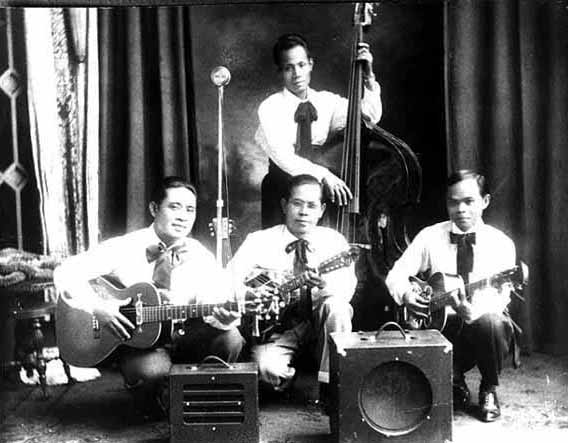
Photo courtesy Minnesota Historical Society
Chip Holk of the Historic Minneapolis Minnesota Facebook page had posted this great photo. MHS identified it as such:
“Gene’s Surf Riders,” Filipino-American musicians playing at the Crown Cafe, East Hennepin, Minneapolis. Unknown date.
Members of the band were identified as :
Gene Laguban
Victor Maglellan
Rupert Santiago
Andy Viray
And just because there is a second photo of the band, let’s put that one up too:
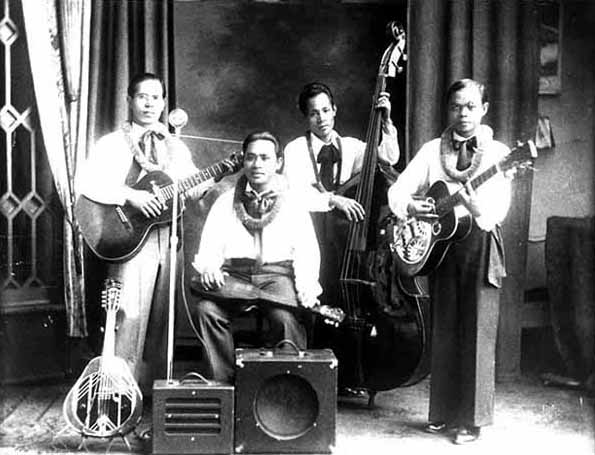
Photo courtesy Minnesota Historical Society
The intersection of Eustis and Larpenteur was hopping with three bars. Perley Bagge owned a bar of the northwest corner. It was mostly filled with men. The Crown Café on the southwest corner had a mixture of men and women patrons. The Barnes Café on the northeast corner had many booths and a nice dance floor, a place you’d prefer to take your lady.
On December 21, 1936, his store caught on fire and Nick called police and fire from both St. Paul and Minneapolis. He said later he would have called the Marines too but didn’t have their phone number. (date from Minneapolis Journal)
In 1941 Nick put in a classified ad selling 11 booths.
In the 1940s Nick was accused of selling liquor to an underaged sailor. Nick avoided conviction because the sailor had been sent off to war when the trial came up.
On June 29, 1944, the Minneapolis Star reported that the Rose Township council approved three tavern renewals for Ramsey County commissioners’ approval, but residents protested renewal of three taverns (very close together) located at 2499, 2500, and 2505 Larpenteur. The licenses of these three taverns expired before the Township council met again. This may have been the end of Nick’s.
Duane’s dad says,
I want you to know that Nick Crown was well liked in the neighborhood. If nothing else he was appreciated as a neighborhood “character.”
When Hwy 280 was built in the 1950s, Nick’s home was displaced by the highway. Nick Crown moved to Hollywood where he spent the rest of his life.
Thank you, Duane and Dad!
Please see the Iron Horse.
The Crystal Coliseum was one of the Twin Cities’ most important venues because it was one of the first – if not the first – dance halls in the area that booked rock ‘n’ roll bands on a regular basis in the 1950s and early ’60s. It’s also the place where Del Shannon and hundreds of teens barely escaped with their lives.
Its advertising always described its location as “1 Mile West of Beltline on Highway 52.” Translation: the Beltline is Highway 100 and Highway 52 is now Highway 81. Ultimate translation: 5313 N. Lakeland Ave., Crystal. Lakeland Ave. is a dead-end service road of Highway 81.
The building was reportedly built in about 1954 by L.Z. Carlson Builders, although the earliest ads under the name Crystal Coliseum in May 1958 call it “New.” In addition to dances, activities in the building included swap meets and wrestling matches. It did not have a liquor license but it did serve beer on “Adults Only” nights.
Although several sources indicate that the building was owned by Bob Zimmerman of Crystal, another said that Zimmerman was in the process of buying it from William R. Jessup, who lived in Shorewood. Zimmerman was in the process of applying for an on-sale liquor license and building a modern cocktail lounge and convention center.
The facility could hold 500 people, according to the ad below, placed on August 17, 1958. The ad also indicates that there may have been a manager named Cavanaugh.
LOVELY new Crystal Coliseum ballroom rentals. For weddings, banquets, business meetings & parties. Many good dates avail. Accommodations up to 500. Mr. Cavanaugh.
ROCK ‘N’ ROLL!!
This venue hosted early acts like Augie Garcia, Mike Waggoner and the Bops, and the bands that David Hersk recorded on his Gaity label, including the Glen Rays, the Flames, the Sonics, the String Kings, and Jim Thaxter and the Travelers, a precursor to the Trashmen.
Sherwin Linton remembers playing the Crystal Coliseum, and has shared these memories:
When I first Came to Minneapolis in January 1958, I was a guest on Harry Zimmerman’s “Hi Five Time” Dance party on KSTP TV. That led me to the Crystal Coliseum in February of ’58. I performed as a guest with The Flames, led by Bobby Hanson, a super guitar player. Most bands at that time in the TC were just instrumental groups so being a singer I got some special recognition. Later I played there with my Rockabilly Band, “Sherwin Linton and The Rocketeers.” By the summer of ’59 I was hearing a lot about “Mike Waggoner and the Bops” and getting a lot of requests to sing “Honey Hush” because Mike did that song so well.
Thanks to the new online searchable database of the Minneapolis papers, I was able to come up with a pretty good list of who performed at the Crystal Coliseum during its brief three years of Rock ‘n’ Roll heaven. So instead of summarizing the data, I’ll try something new and list all of the shows I found. If you are, or know who some of these people are (Big Stoop Chamberlain, where are you?) please let me know!
1958
May 16: Friday Eve. – Big Stoop Chamberlain – Teen Dance – 90 cents. This was the first ad in the Strib, and judging from the ad below from the North Hennepin Post, it may have been the first dance ever:
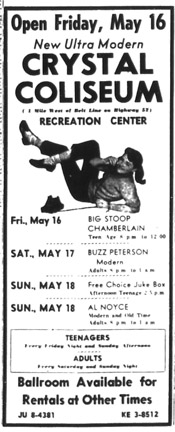
May 17, 1958: Sat. Eve. – Buzz Peterson – Modern – 90 cents
May 18, 1958: Sunday afternoon – Juke Box – 35 cents
May 18, 1958: Sunday Eve. – Al Noyce – Modern – 90 cents
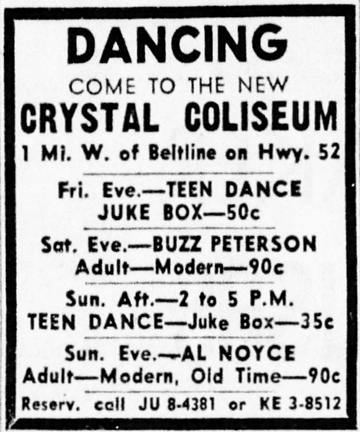
May 23, 1958: Fri. Eve. – Teen Dance – Juke Box – 50 cents
May 24, 1958: Sat. Eve. – Buzz Peterson – Adult – Modern – 90 cents
May 25, 1958: Sun Aft. – Teen Dance – Juke Box – 35 cents
May 25, 1958: Sun. Eve. – Al Noyce – Adult – Modern, Old Time – 90 cents
May 30, 1958: Friday – Blue Kats – Rock & Roll
May 31, 1958: Sat. – Nick Huble – Adult
July 10, 1958: Boxing
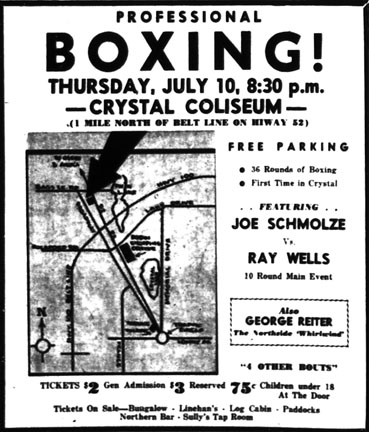
North Hennepin Post
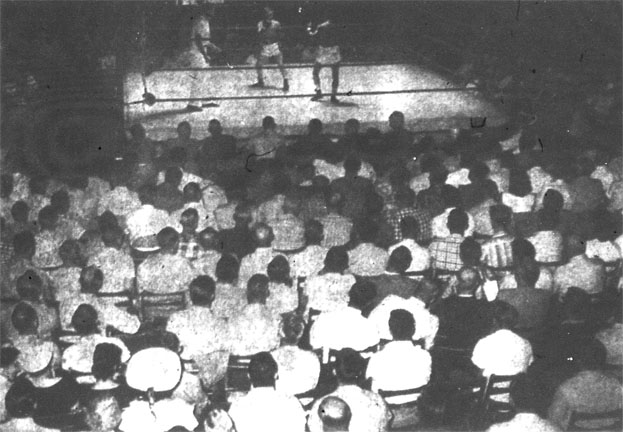
North Hennepin Post
June 14, 1958: Sat – Big Stoop Chamberlain – Adult
June 15, 1958: Sunday Nite – Al Noyce – Adult
June 20, 1958: Fri. – Blue Kats – Teen Dance
June 21, 1958: Sat. Nite – Big Stoop Chamberlain
June 22, 1958: Sunday Night – Al Noyce
June 24, 1958: Tues. – Augie Garcia
July 4, 1958: Friday – Blue Kats
July 5, 1958: Saturday – Country Western – Adult
July 6, 1958: Sun. – Al Noyce – Adult
July 8, 1958: Tues. – Augie Garcia
July 12, 1958: Sunday – Lou DeMars Combo – Modern Jazz – Adult
July 15, 1958: Tuesday – Augie Garcia
July 21, 1958: Monday – Augie Garcia
July 25, 1958: Friday – Forrest Cole & the Embers – Teen Dance
July 26, 1958: Saturday – Al Noyce
July 27, 1958: Sunday – Lou De Mars Combo – Modern Jazz
July 29, 1958: Tuesday – Augie Garcia
August 23, 1958: Saturday – Big Stoop Chamberlain
1959
There were no ads during the winter of 1958-59. Perhaps the place was just too cavernous to heat during the winter. Ads do start up again in July 1959.
July 3, 1959: Friday – The Big M’s – Teenage – Dress Right
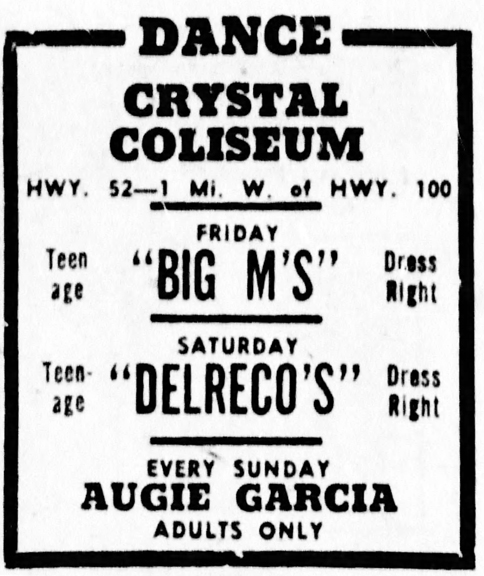
July 4, 1959: Saturday – The Delreco’s (sic) – Teenage – Dress Right (The Delricos included a very young Donald K. Martin, who became a broadcaster on KDWB)
July 5, 1959: Sunday – Augie Garcia (every Sunday) – Adults Only
July 12, 1959: Sunday – Augie Garcia (every Sunday) – Adults Only
July 18, 1959: Saturday – Dick Marrone & his Velvetones – Adults Only
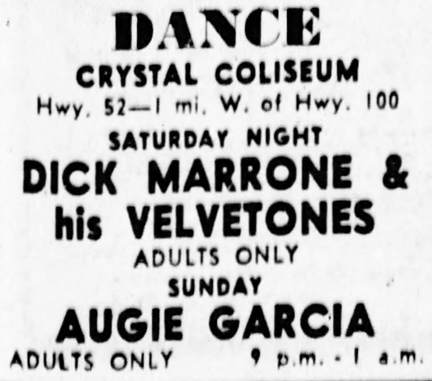
July 19, 1959: Sunday – Augie Garcia – (every Sunday) Adults Only
October 11, 1959: Sunday – Augie Garcia – Adults Only
October 16, 1959: Friday – Teen-Age Hop Featuring WLOL’s Karl Peterson. Dress Right! See You After the Game! (Karl Peterson is listed as Carl Peterson, the Swingin’ Swede, in my list of Disk Jockeys)
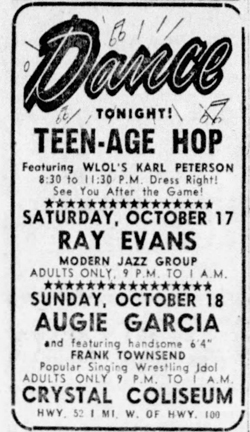
October 17, 1959: Saturday – Ray Evans – Modern Jazz Group – Adults Only
October 18, 1959: Sunday – Augie Garcia and featuring handsome 6’4″ Frank Townsend, Popular Singing Wrestling Idol. Adults Only
October 23, 1959: Friday – Teen Hop Featuring WLOL’s Karl Peterson
November 13, 1959:
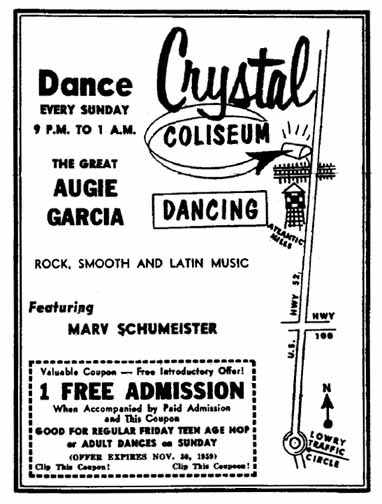
Minnesota Daily ad courtesy Robb Henry
1960
The ads for 1960 were few and far between.
January 31: Sunday – Eddie Lovejoy – His Songs and Guitar, and the Jerry Cole Band – Young Adults
July 13: Dance Wednesday Nite – Rock ‘N’ Roll
August 20: Saturday – Adult Dancing – The Chuck Carson TV Band: Johnny Boyt, Johnny Long, Woody Sorenson, & Others.
September 16: Friday – Teen Hop
September 17: Saturday – Tommy Francis – Young Adults (18 and Over)
September 24: Saturday – Tommy Francis – Rhythm & Blues, Latin & Smooth – Young Adults (18 and Over)
October 1: Saturday – Glen-Rays – Rock, Latin, and Smooth – 18 and Over
December 10: Saturday – Teen Hop
December 11: Sunday – Augie Garcia – 18 and Over
1961
In the spring of 1961, the Crystal Coliseum started to book national acts. Whether it was just these three, it’s hard to tell, but these were advertised in the Minneapolis papers. Mike Waggoner remembers that Jimmy Rodgers (“Honeycomb”) also appeared there on a Saturday night.
May 14: Sunday – Brian Hyland, opened by local group Mike Waggoner and the Bops. Young Adults only (18 and over).
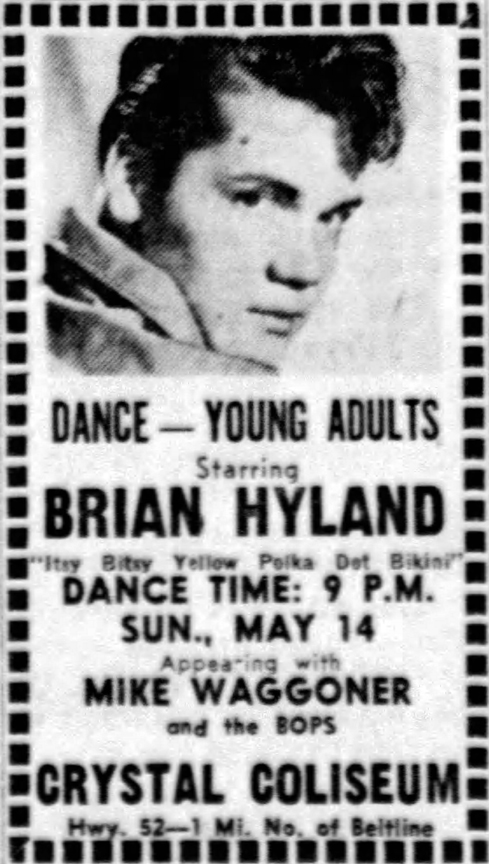
All these years later Mike Waggoner is still playing rock ‘n’ roll, and has graciously shared his memories of the Crystal Coliseum:
The Crystal Coliseum was a very important venue for us early bands and many of the future bands ie Trashmen. The Friday night dances were teen dances, and on Saturday nights they had beer and adult dances. Others that played there on Friday nights were Damon Lee and the Diablos, Jim Thaxter, Del Rico’s, Sherwin Linton, Don Dax and the Dorados and many, many others. Augie was considered the”house” band .. a great showman with a really a good band. The CC was one of the big venues that all of us hoped to play. Bob Zimmerman was the owner/operator of the Crystal Coliseum; a really swell guy who was so very helpful in the early days.
May 19: Friday – Bobby Freeman and Little Johnny Sala, opened by local group Tommy Francis Dance Band. Apparently showing a Hispanic performer on the ad was more acceptable than having a picture of Freeman, who was black, so although Freeman had the big hit (“Do You Wanna Dance” from 1958 – “C’mon and Swim” would come later in 1964), Sala was on the ad. Someone on Facebook also remembers that some thugs tried to break up the dance, but police were called and the show went on.
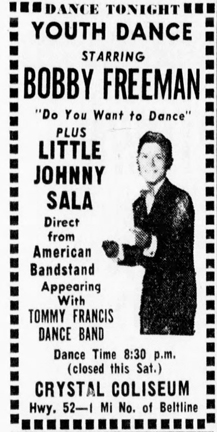
June 2-4, 1961: Friday through Sunday – Del Shannon, opened by local group the Tommy Francis Dance Band.
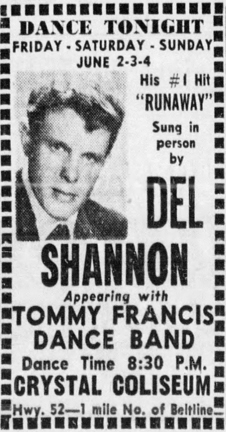
THE CRYSTAL COLISEUM MEETS ITS DEMISE
And then, just like that, it was over. The last of the three Del Shannon shows was held on Saturday, June 4, 1961, ending at about 1:15 am on Sunday morning, June 5 . The janitor left at about 1:55 am. At 2:20 am a nearby gas station attendant saw flames and called the Crystal Fire Department. Eventually about 60 firemen from Crystal, Brooklyn Center and Robbinsdale were required to fight the fire. The fire started in a front office, but was otherwise unexplained. Damage was estimated at $50,000 – although the Quonset hut was intact, the inside was gutted beyond repair. Crystal Fire Chief Wes Tonn said that “flames were leaping from the front elevation when he arrived, and that it was impossible to save the structure.”
I have so far been unsuccessful in finding a photo of the building before the fire. The photo below looks like there’s the word “Dancing” on the left side – not sure what “ALS” would have been on the right. And there may have been a semi-circle marquee at the top that said “Crystal Coliseum.”
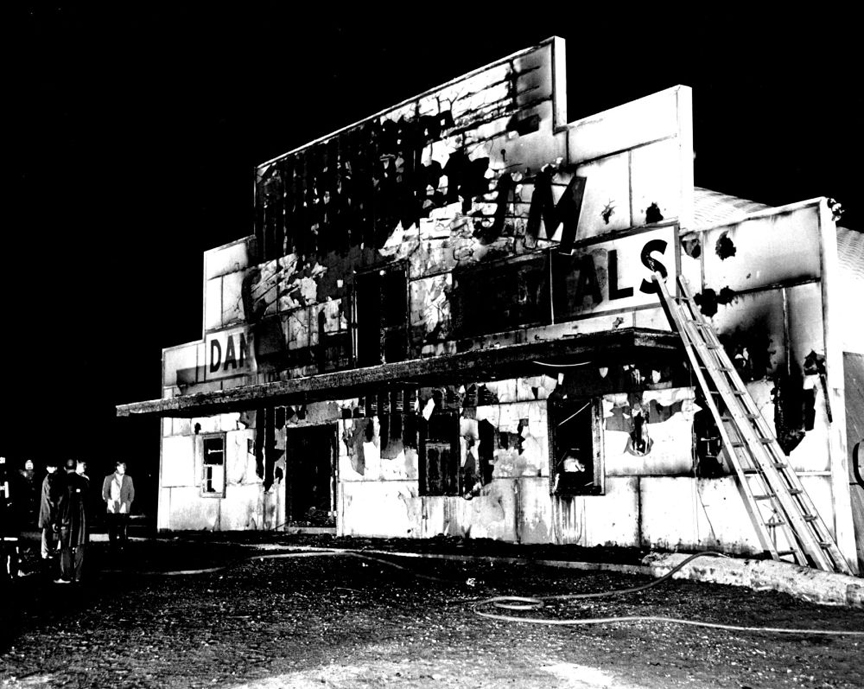
Strib photo by Art Hager, Courtesy Hennepin County Library Special Collections
The North Hennepin Post reported that Zimmerman wanted to rebuilt, quoting him as saying “I want a fireproof building this time. If we put up a new building, it will be fireproof. If we remodel, I plan to incorporates much fireproof material as possible.”
The Post also reported, “Right now, Zimmerman is looking for a temporary location in this area in which to stage his dances which are so popular with the teens – and which are plugged consistently by radio stations KDWB and WDGY.”
Fortunately, everyone was gone before the fire started, but this could have been a real tragedy. Wow.
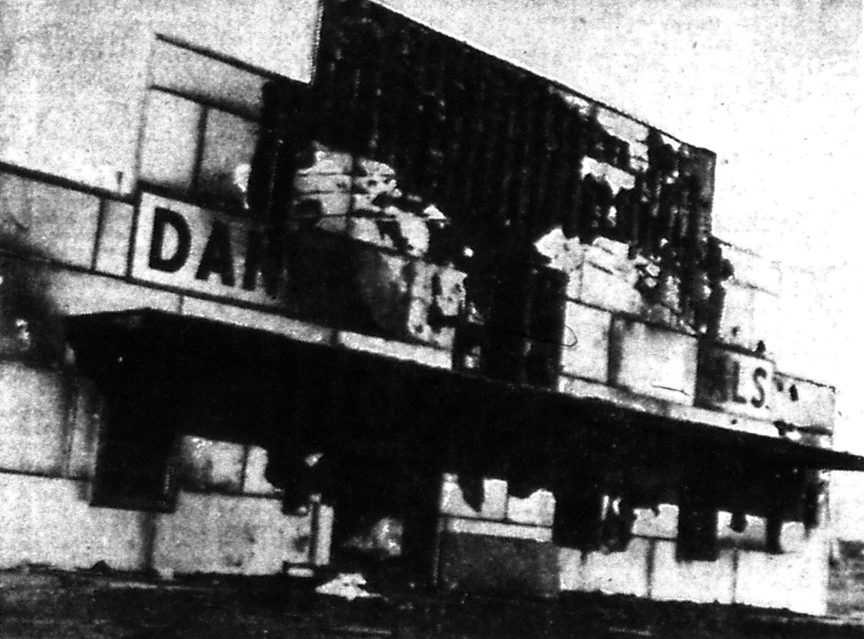
Photo from the other side, North Hennepin Post
Zimmerman never rebuilt, at least in the same spot. The building there now is at 5353 Lakeland Ave. No, which was built in 1999 and is occupied by Rise, Inc., a social service agency.
The Crystal Mist was a bar inside the Maplewood Bowl, which was located at the Northwest Corner of English Street and Frost (1955 English).
THE MAPLEWOOD BOWL
The Maplewood Bowl was developed by businessman Robert Hall in 1961.
Lyfmap.com provides us with a look inside the compound as of November 1, 1961:
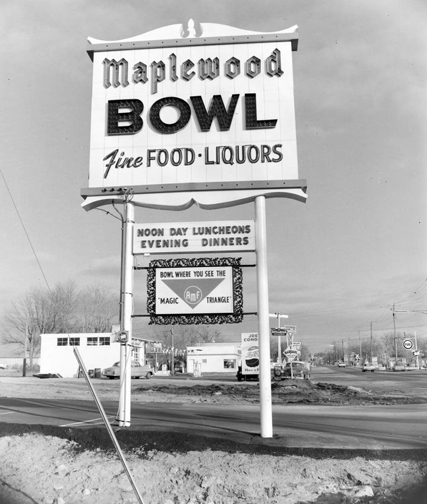
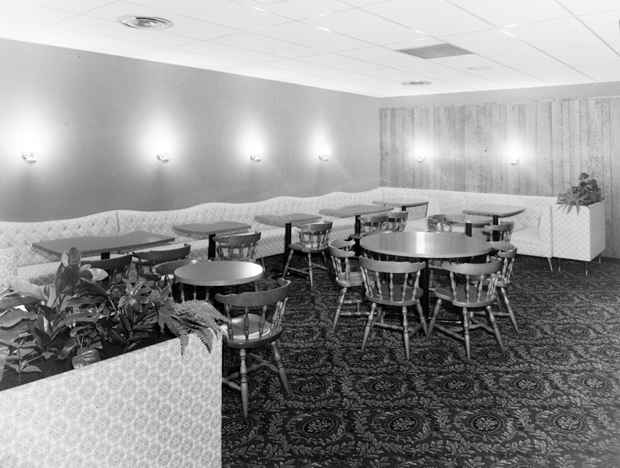
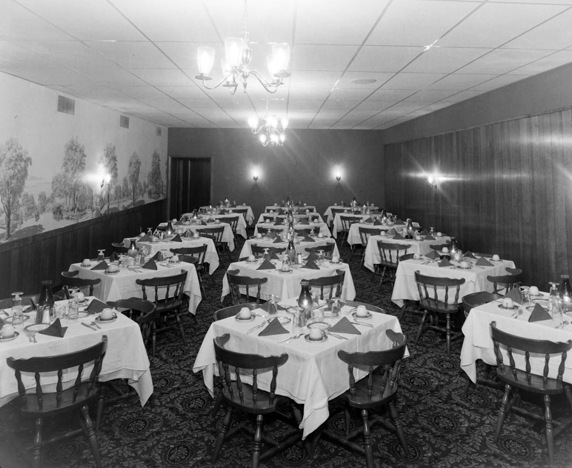
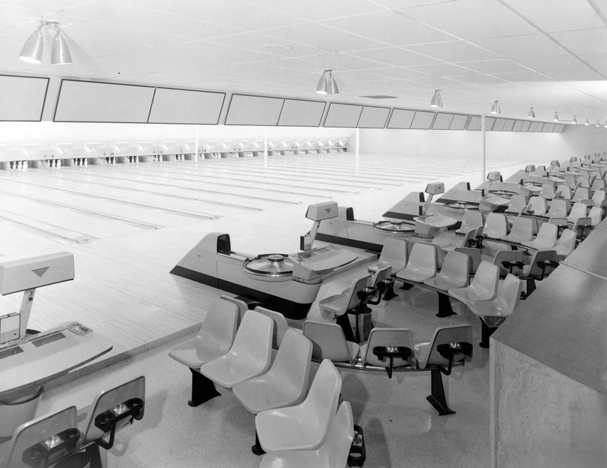
Presumably the picture below is of the bar, chastely walled off from anyone below 21 who might be in the building.
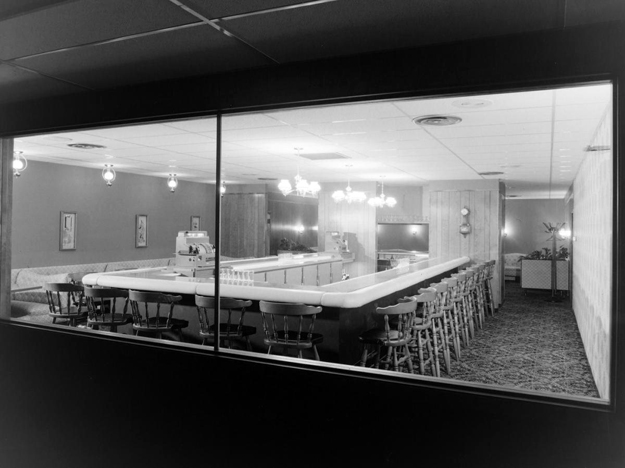
THE CRYSTAL MIST
The Crystal Mist opened in the Fall of 1972, according to minniepaulmusic.com.
A house band for over a year was the Gangbusters:
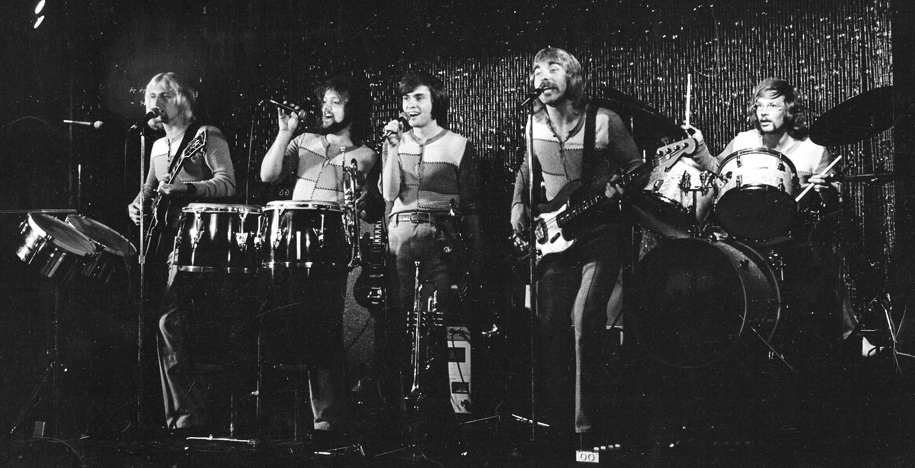
Local group the Gangbusters playing at the Crystal Mist, 1972. Photo courtesy Ken Erwin
Pictured above are: Kent Appledorn; Ken Erwin (former member of the very successful band, the C.A. Quintet); Keith Larsen; Darrel Lichy; and John Chichila (former member of the Deacons).
An article in 1980 said there were two rooms for dancing:
The Playpen upstairs had a stainless steel dance floor.
Downstairs was Fanny Hill’s.
Both featured live bands. (Minneapolis Star, October 17, 1980)
The name of the building changed to Maplewood Lanes and was taken over by AMF, but after a decline in interest in bowling and a change in musical tastes, the Maplewood Bowl had financial trouble and filed Chapter 11 Bankruptcy (still called Maplewood Bowl) on May 18, 1988. Deleano D. Benjamin was named as president. (Minneapolis Tribune May 30, 1988)
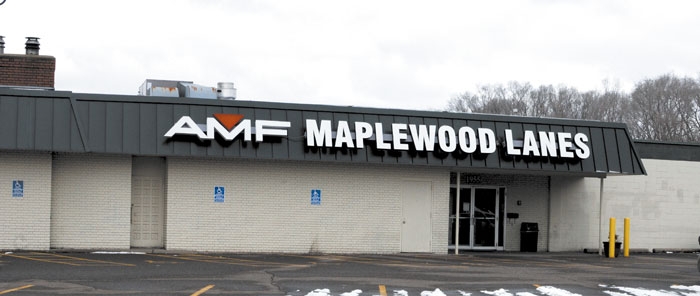
The facility remained open, but appeared more and more on the Theft report. In 1990, one of the venues was renamed Doo Wah Ditty’s Lounge.
Starting on February 14, 1992, it appeared in the Minneapolis Tribune as the “Maplewood Fun Mall.” By December 3, 1993, it was back to the Maplewood Bowl. By September 1995 it was listed as the “Maplewood Entertainment Center.” In October 1996, the club within the bowling alley was referred to as “Neon’s Nightclub.”
Robert Hall owned it in August 1997. He died in November 2014.
The last ad for live music was on April 8, 1988. They tried karaoke in September 1999. What followed were a lot of ads for pipe swaps.
“The Bowl” had to close its doors on April 21, 2013.
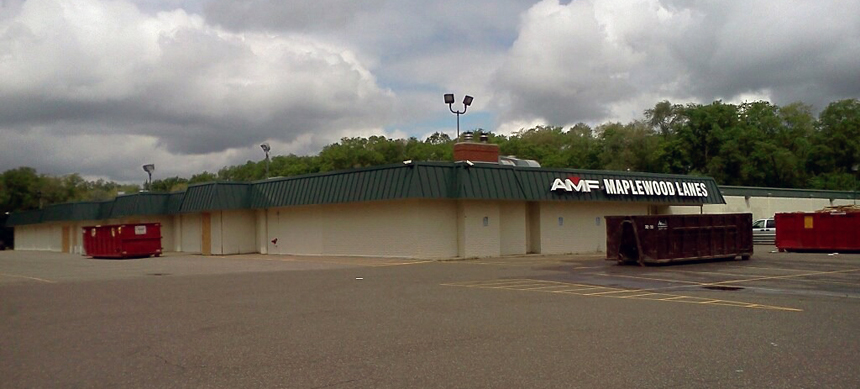
Photo from 2013, just before demolition. Image courtesy Duane Delperdang
The building has been demolished and had been replaced by a large apartment complex.
This property is located at 135 Lakeview Ave., Tonka Bay. County records say it was built in 1946.
CURLEY’S TONKA BAY RESORT
The first hint of Curley’s was an ad dated August 22, 1950, that said that cabins were now available. Less than a handful of ads were found for Curley’s, and they were mostly want ads. The last one I found was dated May 1965. No idea who Curley was, but the property is now the Caribbean Marina, and on their website they say the marina has been owned and operated by the Koch family since 1960.
Donna says “you could drive your boat up to their dock, get a beer and a burger, maybe some music and dance on hot sunny afternoons.”
Warren: “When I was a kid in the early 60s, my folks went there a lot with my sister and me. It was what was known as a “set-up joint” at the time….meaning you furnished your own bottle of booze, they sold you a glass of mix and ice. Free popcorn!”
CURLEY’S CARIBBEAN
Curley’s Caribbean opened in May 1965, with Ginny Herrmann at the Piano Bar.
CARIBBEAN
The venue became just the Caribbean in May 1966.
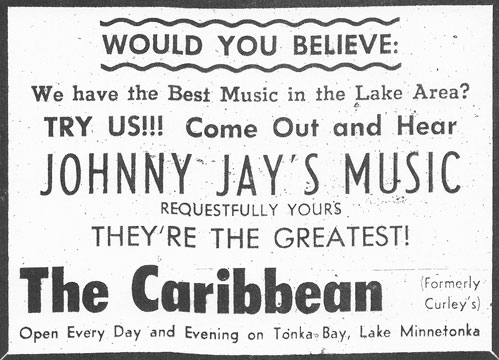
1966 ad from Minnetonka Record
This page covers four venues at two locations
- Curly’s Theater Cafe
- House of Hastings
- Jimmy Heggs’ Starlite Room
- Jimmy Hegg’s
CURLY’S
Curly’s Theater Cafe opened in 1933 at 20 South 5th Street, where the Fifth Street Cash Market had been. This strip joint brought in name acts over the years, but was often in trouble. Curly was apparently Monroe “Curly” Shapiro, who was identified only as an employee in 1933 accounts, the owner being Nate Shapiro. In 1937 it was called Curly’s Cabaret. Most of the time Curley’s featured floor shows and local dance teams. The place was under attack by Rev. Henry J. Soltar, vice crusader and head of the Minnesota Good Government League. Thanks to him, Curly’s got its dance hall and tavern license revoked for having slot machines, but got them reinstated in 1940 with a new owner.
In the early 1940s pianist Bob Zurke played here after working at Mitch’s in Medota. From time to time it also featured some Dixieland bands. In the late 1940s it was “a very swinging place – it was so crowded you could hardly get to the bar.” Curley’s featured jazz trios at the front bar.
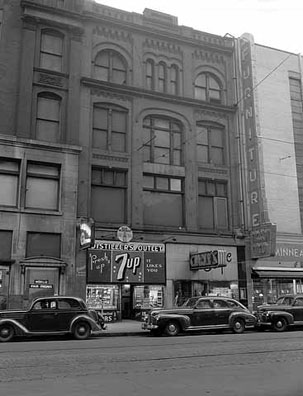
1944 photo from Minnesota Historical Society
In 1952 owner Meyer “Makey” Gordon was convicted of selling drinks after hours and shut down, whereupon he sold the place to Oscar Rubinsky. Matchbook below from Robb Henry.
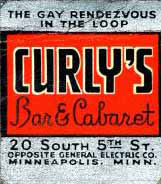
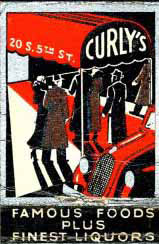
A note on the back of the undated photo below says it is of some doctors whooping it up while in town for a convention (well, not in those very words..). The woman in back is a waitress, and the woman at right is Flora Bell Cook, the same woman who told fortunes at Lindy’s (see that entry for another photo of Flora).
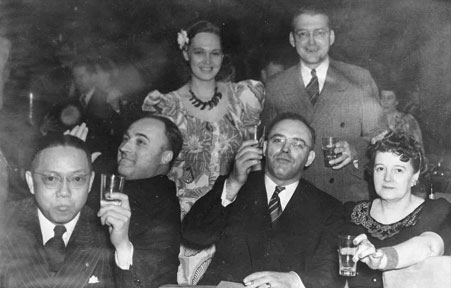
Photo courtesy of the Anne Cook/Gurr photo collection.
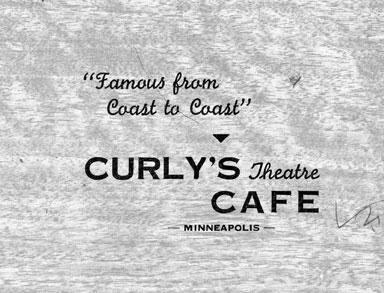
Folder that the photo came in.
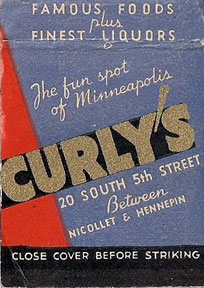
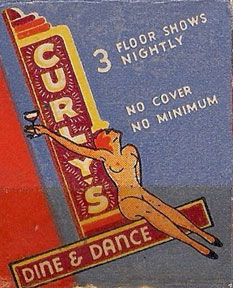
HOUSE OF HASTINGS
The House of Hastings Restaurant replaced Curly’s in 1952. In October 1952 the Minneapolis City Council approved the transfer of Curly’s liquor license from Oscar Rubinsky to Tom E. and Harry Hastings. Tom Hastings had plans to make it over in a Hawaiian theme, but then the Nicollet beat him to it with the Waikiki Room. In October 1952 it was reported that he planned to feature prime rib with Yorkshire pudding “and make a show out of it.” “Non-edible entertainment is planned, too.”
JIMMY HEGG’S STARLIGHT CLUB
House of Hastings didn’t last long – the site became Jimmy Hegg’s Starlight Club in November 1953. Jimmy Hegg had been a singer at Lindy’s in 1937 and at Curly’s since 1938. Doc Evans appeared on November 9th, 1953. Around 1955 or ’56 Ray Komischke fronted the house band.
In April 1959 Cedric Adams reported that the club had started a dance class on Wednesday nights. Dubbed “pupil practice night,” Jimmy brought in famed dance instructor Dean Constantine to teach steps to a Latin band.
JIMMY HEGG’S
There was a fire in 1958/59, and Hegg reopened at 420 Second Ave. So. as Jimmy Hegg’s Restaurant. It became a jazz venue in 1963. During the day it catered to cops and lawyers, but after hours it was a popular after-hours destination for theater people, and Dave Moore was a frequent guest. A remarkable feature was a block of cheese (described by one in the know as “pasteurized processed cheese food”) and crackers at every table for the starving theater folk. The restaurant closed in 1982 and Hegg died in 2001 at the age of 90.
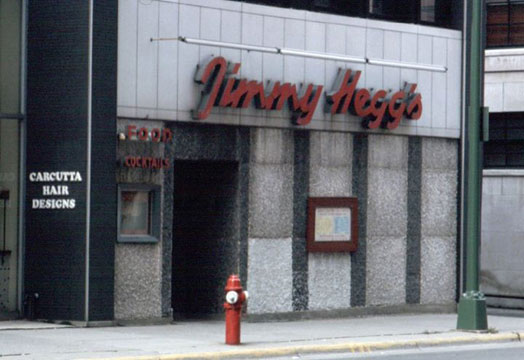
The Curtis Hotel was at 3rd Ave. and 10th Street in Minneapolis. Dick Long and His Curtis Hotel Orchestra was there as early as 1928; in 1933 he debuted his new 12-piece band at the Saturday Night Frolic. Long was also at the Nankin. It was reported by Stebbins that he was at the Curtis for 47 years, so this need clarification. Various venues included:
- Turquoise Lounge, 1952
- Cardinal Room, 1963-1970. Dinnerr fashion revuies by Jackson Graves on Tuesdays in 1963.
- Garden Lounge. 1967: pianist Jimmie Cooper; 1970: pianist entertains nightly.
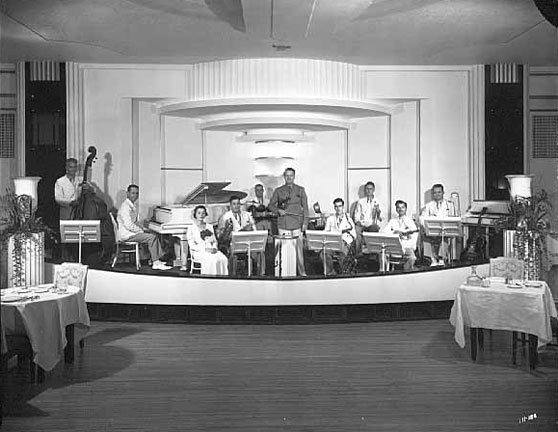
Dick Long and His Orchestra at the Curtis Hotel, August 26, 1935. Courtesy Minnesota Historical Society
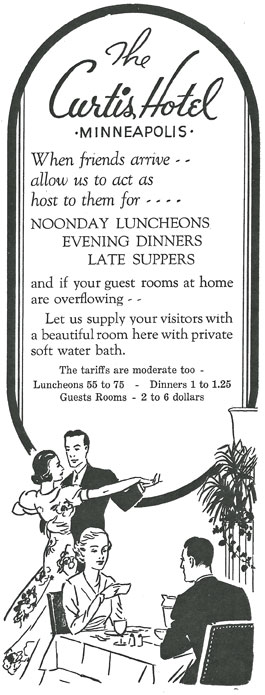
1939 St. Louis Park Directory
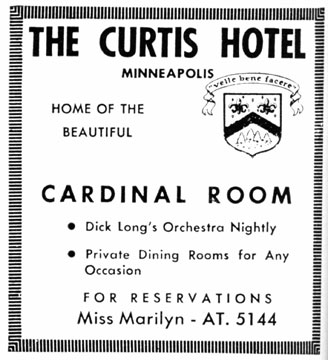
1954
This Danceland was located at 1515 W. University Ave. in the Midway district of St. Paul. Blink and you would have missed it.
A search for the address shows that the building was the Midway Service Garage, owned by Robert K. Vitrud, in 1922/1923.
In 1929 it was the home of the Anderson Motor Company, selling cars.
A want ad-type entry announced the Grand Opening of Dance-Land on March 8, 1940, with music by Slim Jim and the Jolly Millers. On March 10, 1940, Sev Olson and His NBC Orchestra were slated to provide the entertainment.
A curious gap, and then another opening on September 14, 1940, this time with a bigger ad. Ads were more or less continuous until the last one on March 26, 1941. Alas, a dance hall in a car lot failed to draw the dancers.
The building reverted to cars; a June 25, 1941, ad shows that it became a Pontiac dealer. But that ad gives us a picture of the building, at least.
This was a short-lived ballroom on Nicollet Ave. – no relation to the ballroom in Excelsior. Please see Mr. Lucky’s.
NOTES:
- This page does not include other ballrooms (“pavilions” or “casinos”) on the Excelsior waterfront at the turn of the last century; that information is on a separate page about Excelsior’s Dance Halls.
- Many thanks to Lisa Stevens, Scott McGinnis, and the folks at the Excelsior-Lake Minnetonka Historical Society for access to their files and for reviewing this material for clarity and accuracy.
- Unless otherwise cited, the indented quotations are from the Minnetonka Record newspaper.
- The name “Danceland” did not come into being until 1961. The building had several other names before that. I tend to use the word “Ballroom” to mean the building that became Danceland.
- Some of the events below took place in Excelsior Amusement Park’s picnic pavilion. Those are noted as accurately as possible and are included here if music or other popular entertainment is involved.
TONKA BAY
The building that eventually became Danceland started out in a different location entirely. It was built across the bay from Excelsior in the resort town of Tonka Bay.
BEACH PAVILION
Beach Pavilion was built for $10,000 by Everel O. Beach in 1904. Beach originally wanted to build it on the Excelsior Commons, which was public property in Excelsior owned by the Park Board. Although the Village Council approved a lease, saying it would enhance the otherwise unsightly area, Beach withdrew his proposal for fear of opposition from residents. Instead he built it on the grounds of the Tonka Bay Hotel (originally called the Lake Park Hotel), which had been purchased by Thomas Lowry in 1902.
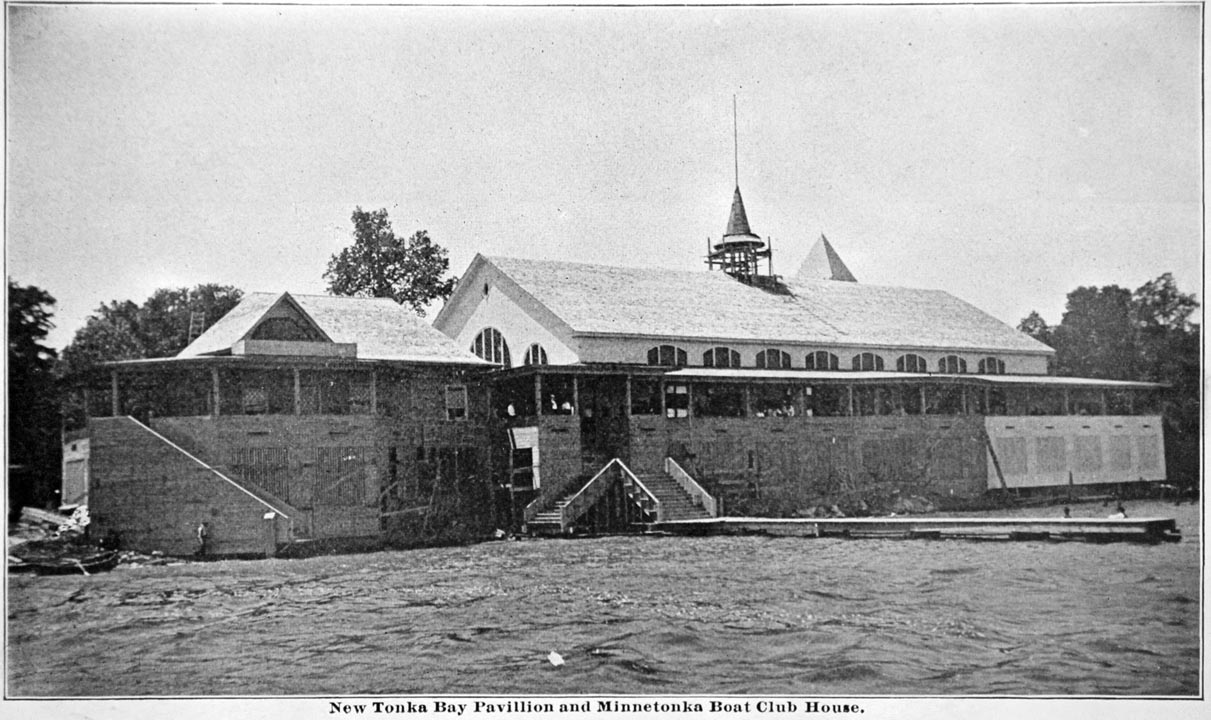
At left is the Minnetonka Boat Club House. Photo courtesy the Excelsior-Lake Minnetonka Historical Society
The Beach Pavilion’s Grand Opening was on June 11, 1904. Interesting that the word “hop,” so associated with the 1950s, was used 50 years before.
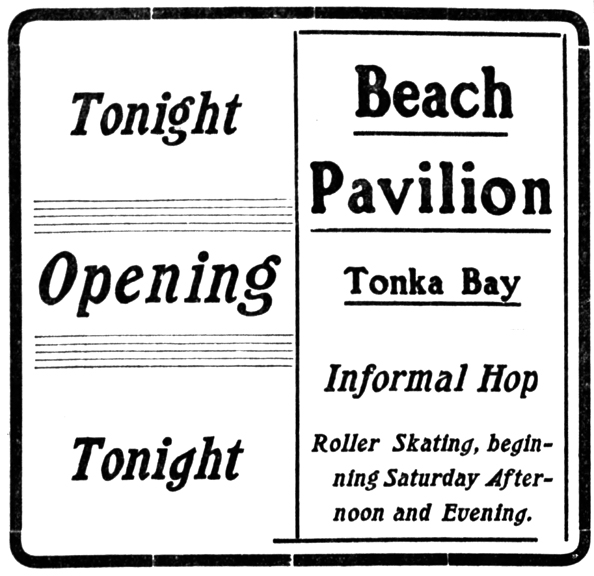
Minneapolis Tribune, June 11, 1904
The following article from the Minneapolis Journal is long, but gives a splendid description of the building when it was first put into service.
FIRST “HOP” TO-NIGHT:
Big Beach Pavilion Will Be Formally Opened at Tonka Bay To-night.
The formal opening of the Beach Pavilion, at Tonka Bay, will take place this evening. The new pavilion is one of the finest in the country in every respect, and will undoubtedly be a most popular resort for the people of Minneapolis and St. Paul during the hot weather. It has an ideal location on Tonka Bay and is splendidly fitted throughout.
The building itself, including the Tonka Boat Club House, which is connected with the pavilion by a porch, includes an area of 275×100 ft. The ball-room is the largest in the Northwest, and has an area of 150×75 ft. Informal hops will take place here every Wednesday and Saturday evening, and there will be roller-skating every afternoon and evening except on the “hop” nights.
There is a splendid billiard-room in connection with the pavilion and a view of the ball-room and the lake can be obtained from the billiard-room. There are 200 feet of porches facing the lake. During the coming week all this porch area will be screened in and will be safe from the attack of mosquitos and other insects.
The electric light system for the pavilion is perfect and there are oriental and different colored lights throughout the whole building. The Tonka Bay hotel, which is owned and managed under the direction of Thomas Lowry, is in close proximity. Light lunches and other refreshments can be obtained any time at the pavilion.
The Beach Pavilion is to be conducted by up-to-date methods and is bound to be very popular with lovers of Tonka.
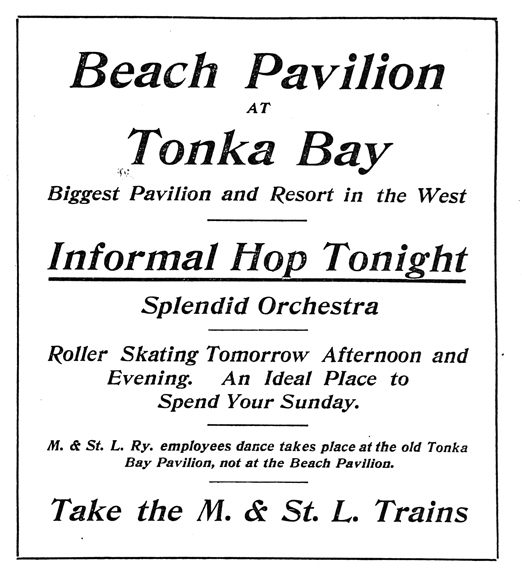
Minneapolis Journal, June 18, 1904
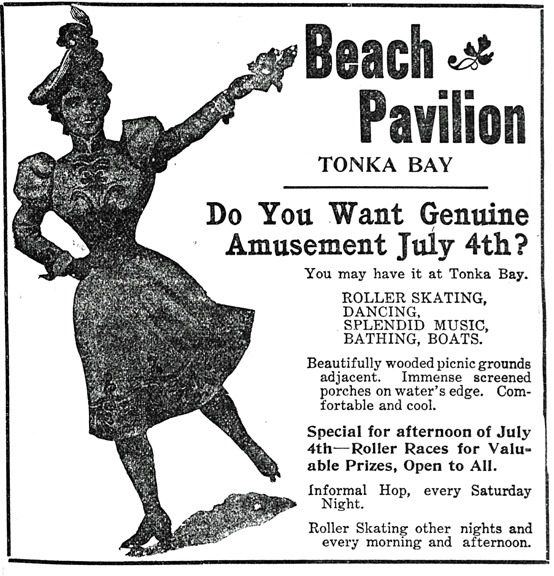
Minneapolis Journal, July 1, 1904
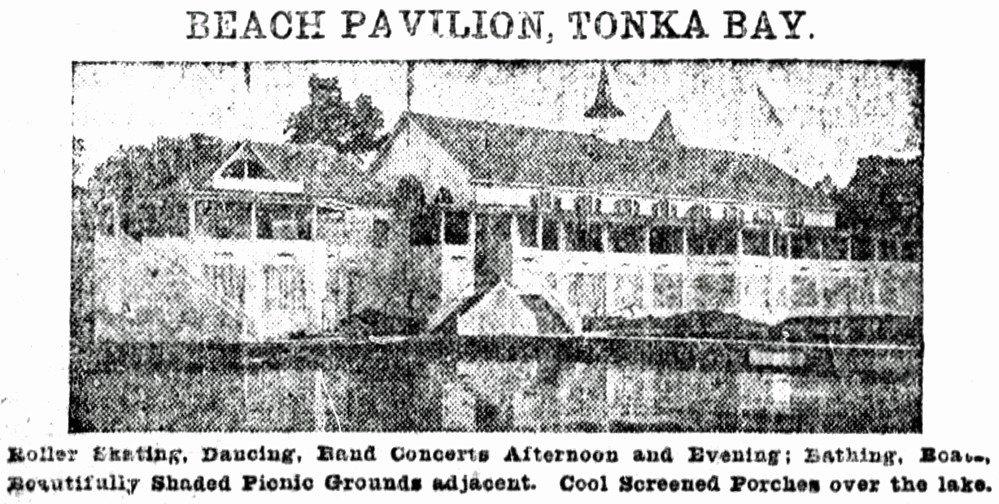
Minneapolis Journal, July 26, 1904
TONKA BAY PAVILION
Beach had borrowed the construction funds from Thomas Lowry, who was then stuck with the debt when Beach fled Minnesota in the Fall of 1904 as he was about to be indicted for embezzling funds from the Minnesota Transfer Railway Company. In 1930, Beach was a resident of the Illinois State Penitentiary at Joliet. Even that didn’t cure him of his swindling ways; in 1940 he was a guest of the Los Angeles County jail.
Lowry took control of the building in 1905; an article dated June 6, 1905, reported:
Lowry Now Owns Tonka Pavilion – Acquires More Property at Tonka Bay and Gives Long Lease.
Thomas Lowry has acquired full possession of the Beach pavilion at Tonka Bay, adjacent to his hotel, the Tonka Bay. He has given a three-year lease to Edward Shumpik and John G. Lund, who will operate the roller skating rink and other accessories of the establishment. The same interests control the Casino rink on Washington avenue N.
The Minnetonka Boat club will continue to occupy its quarters in the pavilion building. The structure cost $18,000. The site was already owned by Mr. Lowry.
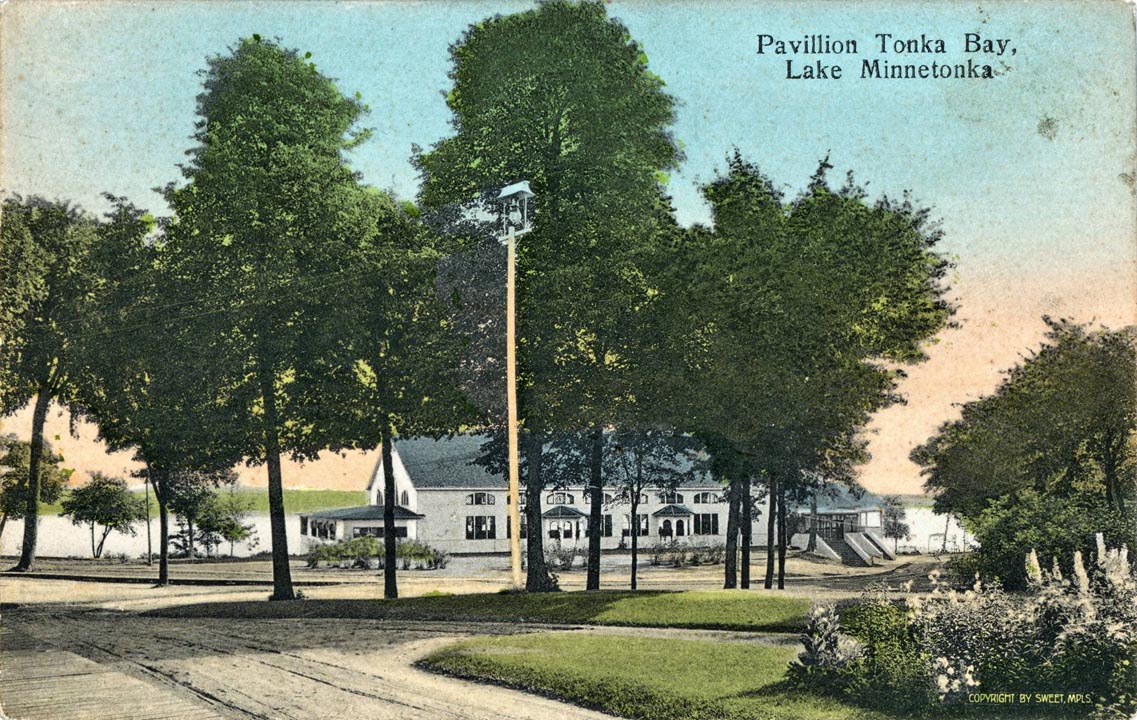
Photo courtesy the Excelsior-Lake Minnetonka Historical Society
The name of the place changed with the tides:
- Tonka Bay Pavilion
- Tonka Bay Roller Skating Rink
- Tonka Bay Roller Skating Casino
- Tonka Bay Casino
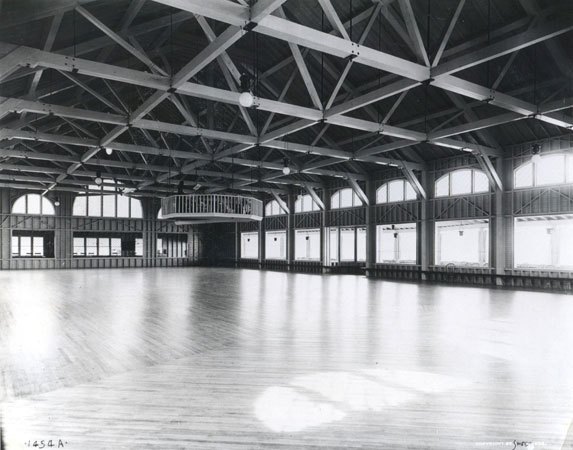
Tonka Bay Pavilion, 1904. Photo courtesy of the Excelsior-Lake Minnetonka Historical Society
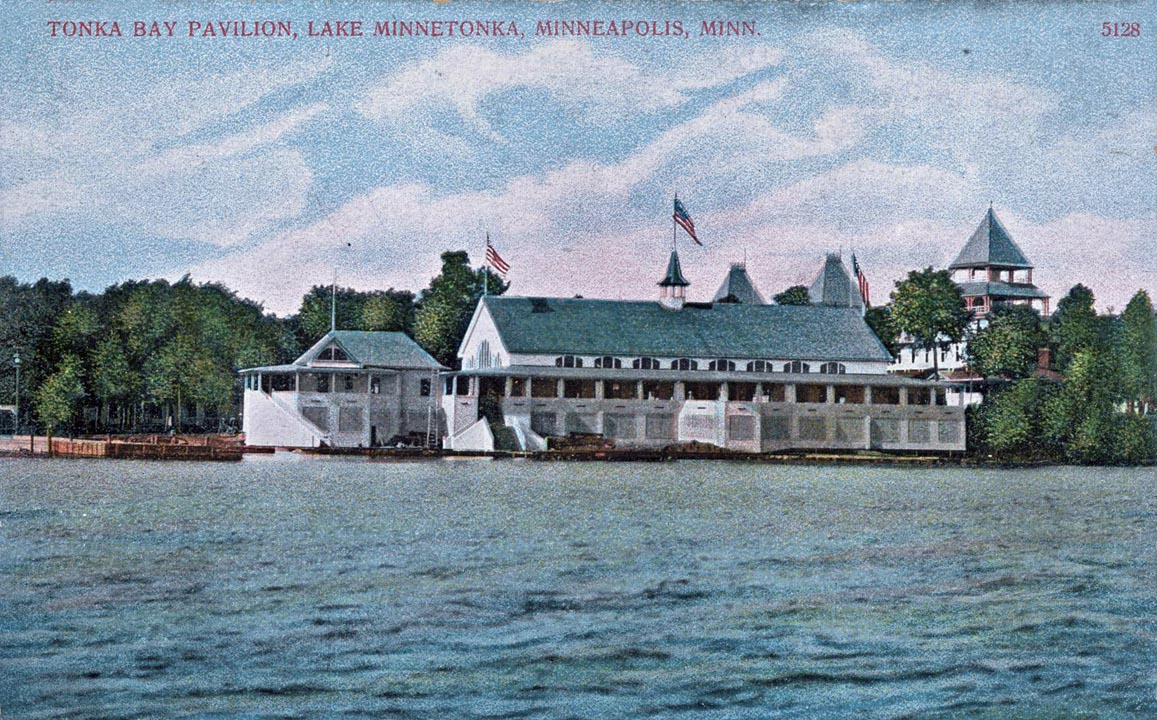
Photo courtesy the Excelsior-Lake Minnetonka Historical Society
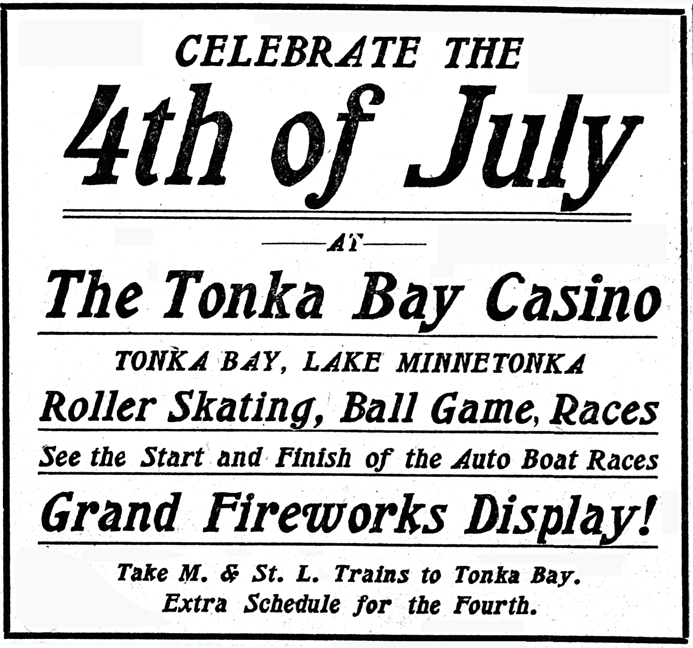
Minneapolis Journal, 1905
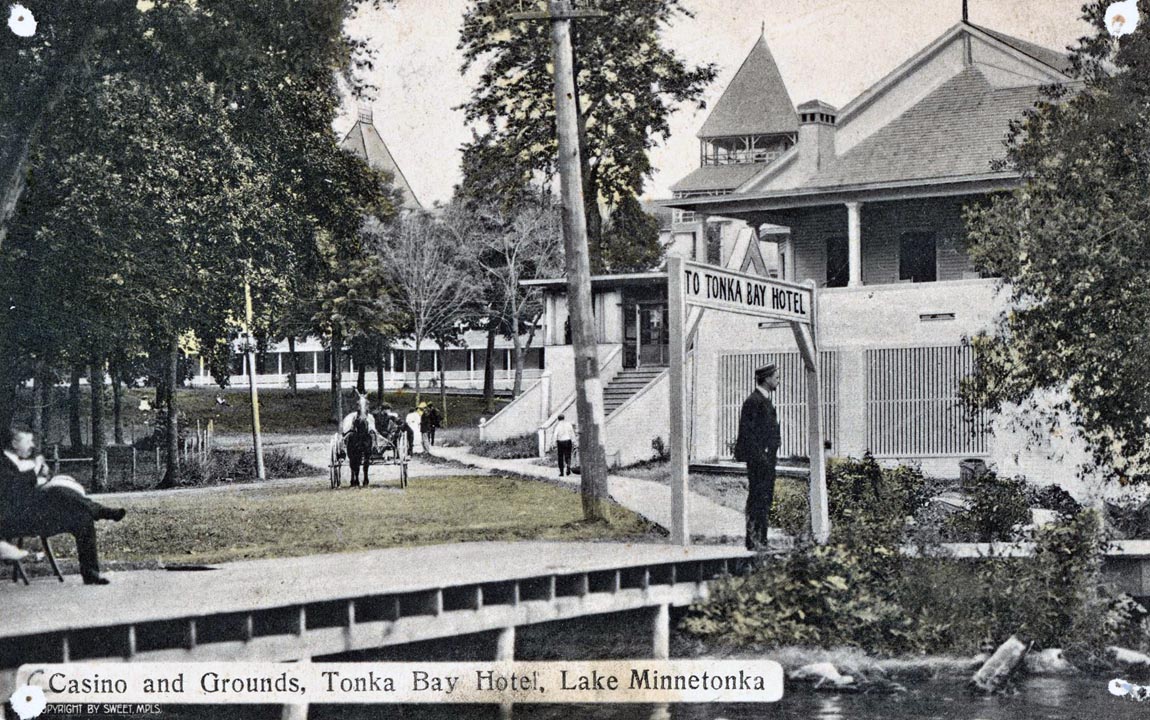
Photo courtesy the Excelsior-Lake Minnetonka Historical Society
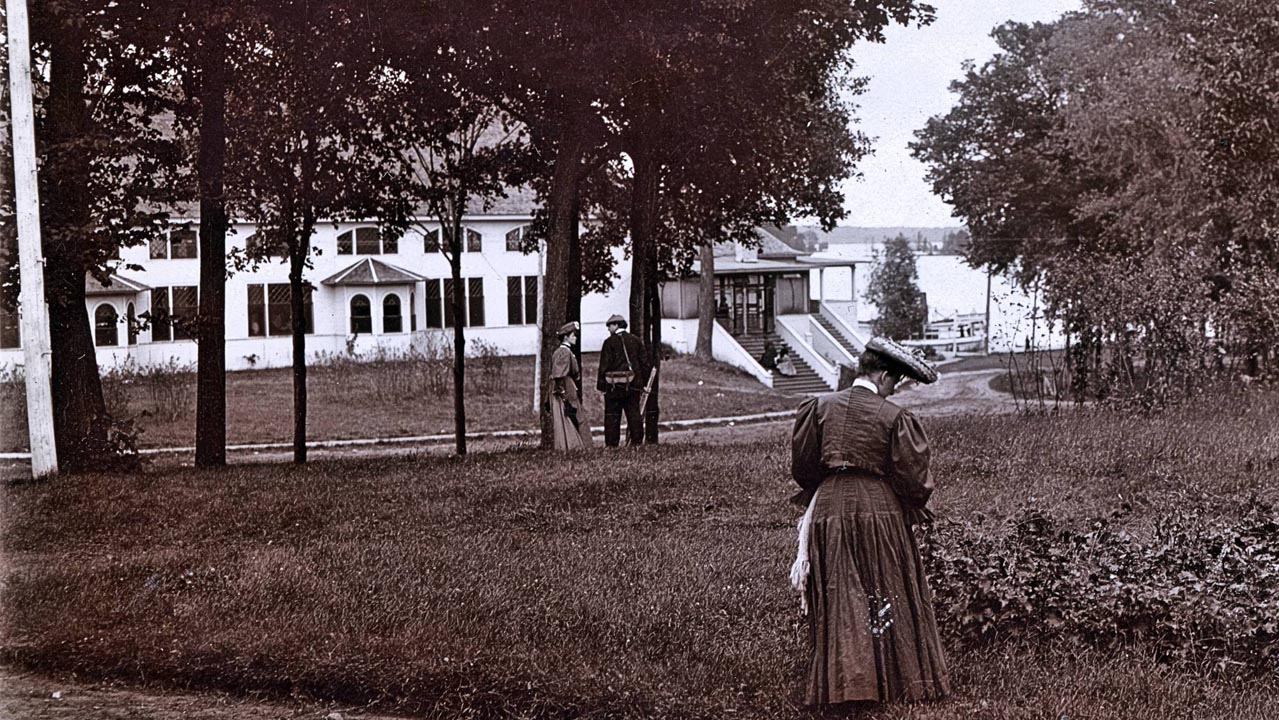
Photo courtesy the Excelsior-Lake Minnetonka Historical Society
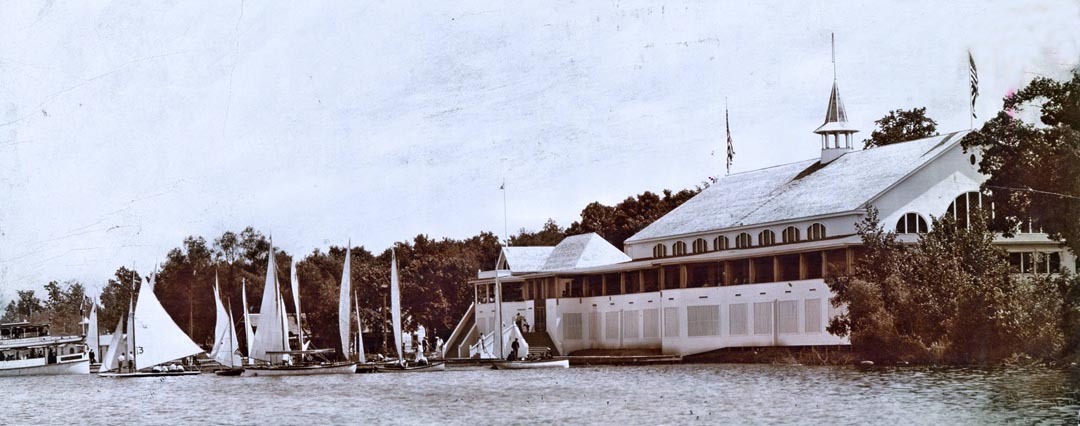
Photo courtesy the Excelsior-Lake Minnetonka Historical Society
1920
On January 23, 1920, Horace Lowry, president of the Twin City Lines (streetcar), offered the Tonka Bay roller skating pavilion as a gift to the Excelsior park board for use on the Excelsior Commons. Bonds would have to be voted on to raise funds to move the building from Tonka Bay to Excelsior. “It would serve as a center for housing summer concerts and entertainments and would afford shelter to picnic crowds in case of sudden storm.”
1922
On October 13, 1922: It was reported that Eber Armagost and J.E. McNiece of Excelsior had purchased the Tonka Bay casino and were having it razed. “The lumber will be used to build a new casino at the street railway dock station in Excelsior. It will be 100×150 feet and will be completed by spring. J.E. Weinholz has the contract.” Armagost worked for the trolley company.
In the winter of 1922/1923, instead of being razed, this building was dismantled, the porch was removed, and the structure was moved across the bay. It opened in its new location on May 5, 1923. The floor, again used for roller skating and dancing, measured 75 x 150.
Legend has it that the building was towed across the frozen Lake Minnetonka from Tonka Bay to Excelsior. It seems that if that had happened it would have certainly been sensational enough to be in the newspaper, but I found no such report, either in the Minnetonka Record or in the Minneapolis papers. Further confusing the matter is an article from July 1953:
Joe Weinholz, the Excelsior contractor, told the story of how he and his crew moved the 66×140-foot structure from Tonka Bay:
First they took apart the roof boards and took down the trusses. Then off came the porches. The walls were sawed into 14×22-foot sections and carried down to the shore and slid over the bank on to a barge. From there, they were carried across the lake to the shore of what is now the Amusement Park and then rolled across the road to the present site of the ballroom. The timbers and underwork of the building, and the floor sheeting were all loaded on trucks and brought over to Excelsior.
Does the word “barge” imply open water?
It appears that the Tonka Bay Hotel was also removed. An ad dated April 22, 1923, reads:
A Rare Minnetonka Opportunity
One of the most pleasing tracts of land around Lake Minnetonka; one of the last, if not the very last of the really desirable unoccupied tracts on the lower lake, the beautiful spot where Tonka Bay Hotel and pavilion once stood [emphasis added] is to be platted and sold as lots.
Before the plat is completed we will consider proposals from those who desire sufficient ground to build larger homes. But this requires immediate action.
The restrictions upon this property assure a community of the most desirable sort. The facilities and services of all kinds, including year-round transportation cannot be surpassed at any location at the Lake.
The plans under way will make this one of the most sightly and attractive communities around the lake. Because of the extreme desirability of this location; the unusual beauty of this highly wooded tract; and the scarcity of rally good Lake sites we are able to select the purchasers with care to insure a thoroughly high class community.
It will pay you to be forehanded. Write or phone at once.
Northwestern Suburban Realty Co., 1211 McKnight Bldg. NOTE: This is a newly formed corporation, most of whose members already own and occupy homes at Tonka Bay.
EXCELSIOR
1923
LAKE VIEW PARK PAVILION
On April 22, 1923, the Minneapolis Journal reported on the Pavilion then under construction in Excelsior.
It is located near the street railway station, and will be opened early in May. J.E. McNiece, who operated the old pavilion, is the owner. D.C. Bennett, Inc. are the architects and builders. Of frame construction with stucco exterior, the building is 50 feet wide and 150 feet long. This area does not include the spacious porches running across the front and the entire length of one side of the building. The structure will cost $30,000.
Minnetonka Record, May 4, 1923:
Lake View Park Pavilion, the new casino near the dock station in Excelsior, will open Saturday [May 5] evening with a ball. The pavilion is the former roller skating rink that stood on the lake front at Tonka Bay. It was purchased last fall by E. Armsogost and J.E. McNiece, taken down in sections and re-constructed in Excelsior.
The pavilion occupies a strategic position here. It is on the Yellowstone Trail [Excelsior Blvd.], at the dock station, where all trolley cars stop before entering the heart of town and near the shore of Excelsior Bay, which has been dredged out and will be provided with piers for the landing of boats. The dancing floor is 75×150 feet, said to be the largest public dancing floor in the northwest. It will accommodate 2000 persons without crowding.
The pavilion will be operated on a strictly high class basis. Special precautions will be taken against liquor and improprieties. The grounds will be brilliantly lighted. There will be a double row of ornamental lights from the dock station to the entrance of the pavilion. Byron D. Wilson will be in charge of policing the building and grounds, with assistants on duty at all hours. Mr. McNiece will be actual manager of the pavilion and will have dance floor managers to see that nothing improper is permitted.
There is room for parking 500 automobiles on the grounds. Watchmen will be on duty to protect patrons’ cars.
It is the plan of the proprietors to erect additional buildings at the end of the season. There will be buildings devoted to various forms amusements added, until an amusement park of large proportions is assembled.
Lake View Park dancing pavilion had its Grand Opening on Friday, May 25, 1923, with souvenirs and novelties for all. There was dancing every Wednesday and Saturday; Gents got in for 55 cents, Ladies for 30 cents. Music was provided by the Clarence Peterson Lake View Park Orchestra.
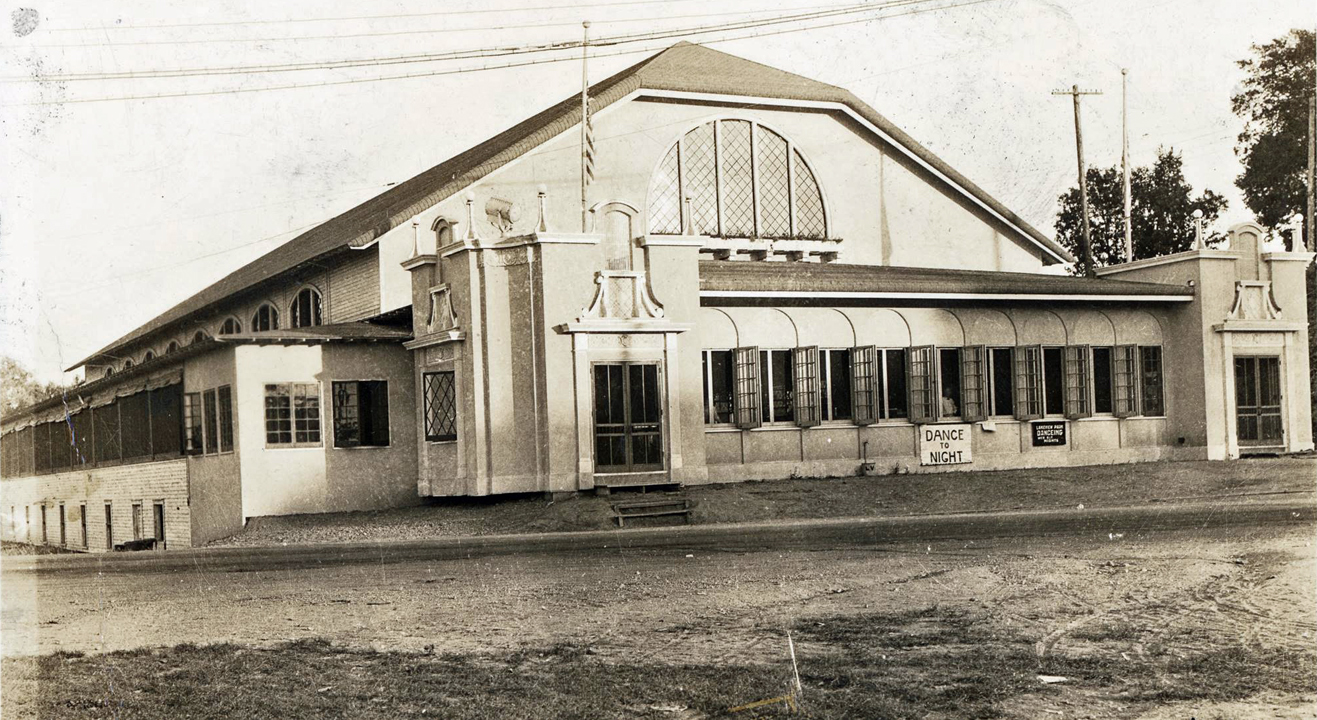
Early photo of “Lakeview Park” – with “Danceing!” Photo courtesy the Excelsior-Lake Minnetonka Historical Society
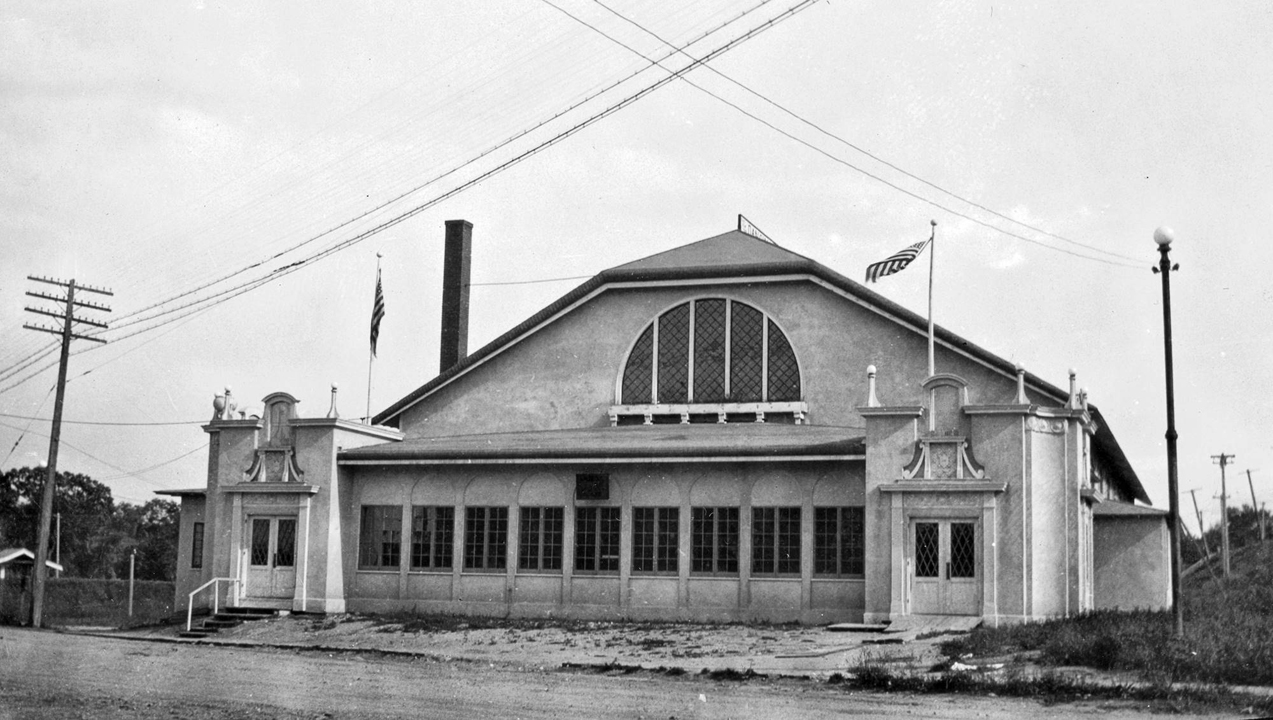
Another photo from early days, courtesy the Excelsior-Lake Minnetonka Historical Society
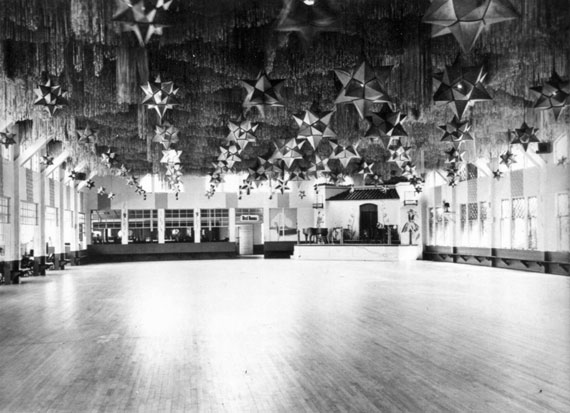
Photo courtesy Excelsior-Lake Minnetonka Historical Society
DANCING ON SUNDAY!
Lake View Park Pavilion introduced dances on Sundays in July 1923. This caused consternation among the members of the Women’s Club, supported by “the church people.” “The question is being discussed as a moral problem People are debating whether Excelsior should abandon its time honored custom and be the first village in the lake region to permit the operation of public dance halls on Sunday.” The question was left up to a public referendum that was held on Saturday, July 21, 1923. Despite a big “Vote NO!” ad in the Record, the tally was 252 for Sunday dancing and 205 against.
A “monster dance” was held on Hallowe’en 1923 at Lake View Park Pavilion. Tickets were sold for two months prior, with the prize of a five passenger Star touring car promised as the prize. Although the music was deemed “adequate,” the party was a great success, with the dance floor filled with patrons from the cities and the lake region.” The car was won by Miss Hazel Holman, who worked for the George H. Hasher Grocery Store.
October 26, 1923: Lake View Pavilion to Have Heating Plant. Two hot air furnaces were installed for Saturday dances. Basketball games were also held in the pavilion.
1924
April 26 was the start of the 1924 dancing season, with Saturday night dances until the regular summer season began in June. Music was again provided by Clarence Peterson’s Lake View Orchestra (eight pieces). Eber Armoagost received a six months’ leave of absence by the trolley company so he could devote his time to the Pavilion.
In September 1924, what would become Excelsior Amusement Park was first proposed by the Fred W. Pearce Amusement Company of Detroit. “An overhead bridge of ram (sic) leading over the Yellowstone Trail (Excelsior Blvd. – Highway 7 wasn’t built yet) to the Lake View Pavilion are included in the plans.”
1925
On March 27, 1925, the Excelsior Athletic Association put on a show that included:
- Kiddie Kar Polo games
- Basketball games (Excelsior fats vs. Excelsior leans – “Last year the leans had it on the fats, but the fats have been training and are fatter this year, and should be able to hold their own.”)
- Wrestling and boxing matches among local boys
- Music by the Excelsior Band
Dances were held at the Pavilion every Saturday night (May 1, 1925).
EXCELSIOR AMUSEMENT PARK OPENS
Excelsior Amusement Park opened on May 23, 1925, on property which originally housed a terminal for ferry boats to Big Island Amusement Park. It was located across Excelsior Blvd./2nd Ave. from the Ballroom, which was sometimes called the Lake View Pavilion and sometimes the Excelsior Dance Pavilion.
The Amusement Park was situated on 17 acres of land. In an interview, Pearce described building the Park as the most unusual job.
Some 10 acres of swamp had to be filled in, with a present lake frontage of 1,600 feet. The rides were first built on pilings, and then the solid ground was filled in around the pilings. The crew worked all the winter of 1924 – ’25 on this project. (Billboard, July 30, 1949)
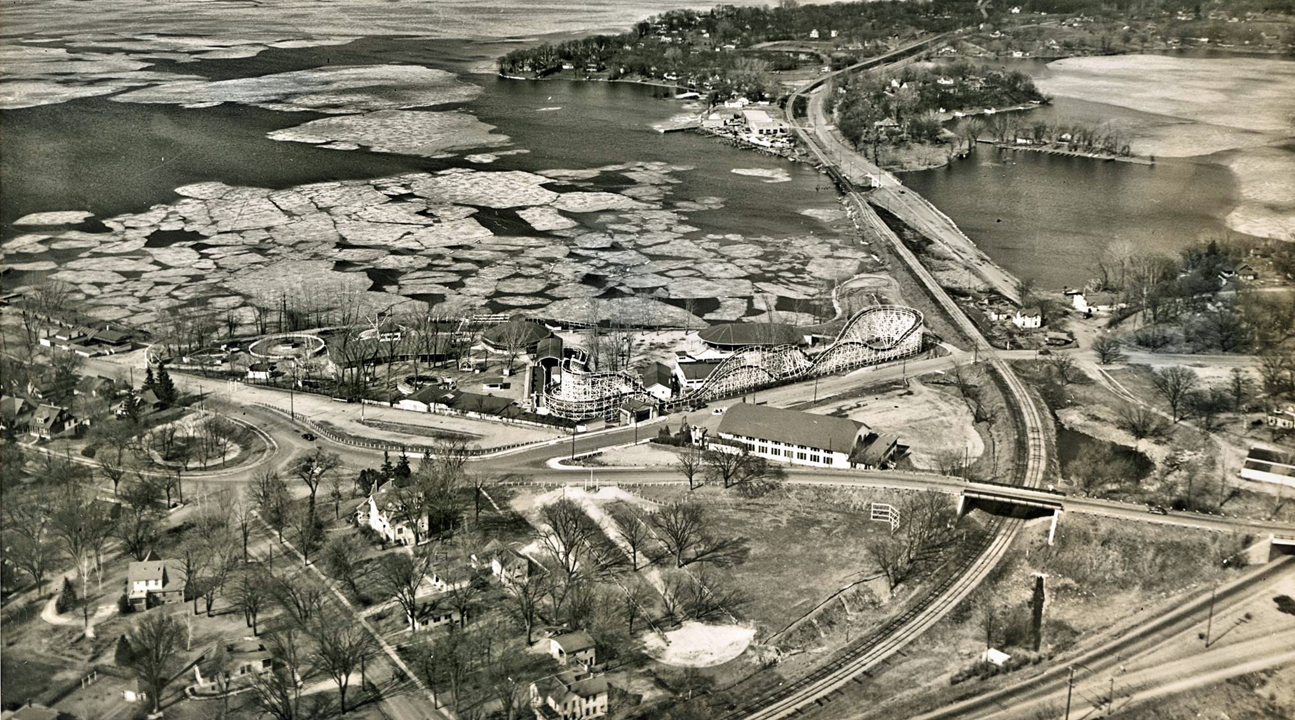
Photo courtesy the Excelsior-Lake Minnetonka Historical Society
Frederick W. “Bill” Clapp, Fred Pearce’s 25-year old cousin, was named assistant superintendent, overseeing the park’s construction and operation. Lorenzo C. “L.C.” Addison was the general superintendent of construction and the park’s first general manager.
That first day of operation, there were 11 attractions, drawing 20,000 people.
Early ads were quite dramatic!
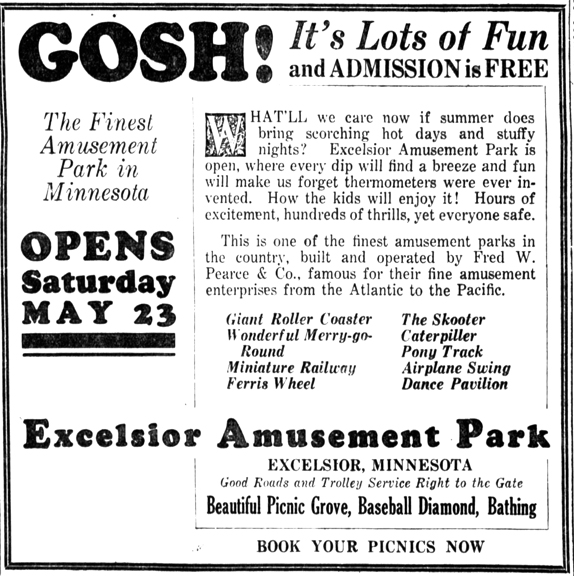
May 21, 1925 – Minneapolis Star
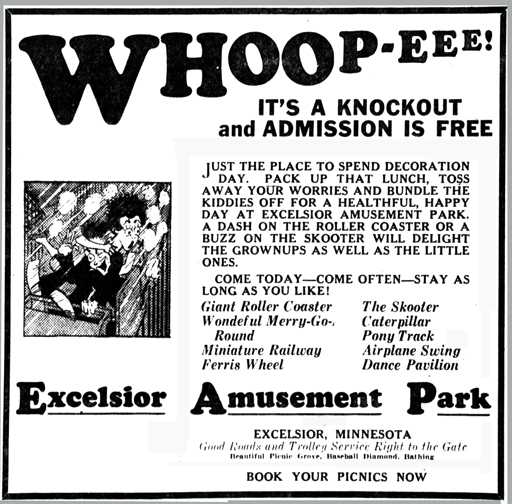
May 28, 1925 – Minneapolis Star
September 11, 1925: Although the end of the Lake season was at hand, “The Lake View Pavilion, which has become the most popular dance pavilion around the lake, will continue to have dances three nights during the week, Wednesday, Saturday and Sunday.”
1926
On March 31, 1926, a program with 19 pieces was presented by the Excelsior band, directed by H.O. Carciofini. One of the numbers was “By the Waters of Minnetonka.” Dancing followed.
EXCELSIOR PARK PAVILION
An ad dated May 15, 1926, tells us that there was dancing every Wednesday and Saturday nights at the Excelsior Park Pavilion, with music provided by Clarence Peterson and His Orchestra.
Dancing may have increased to every night; the roof on the undated photo below advertises weeklong dances, and the paint may indicate that it just recently changed its name from Lake Park Pavilion to Excelsior Park Pavilion.
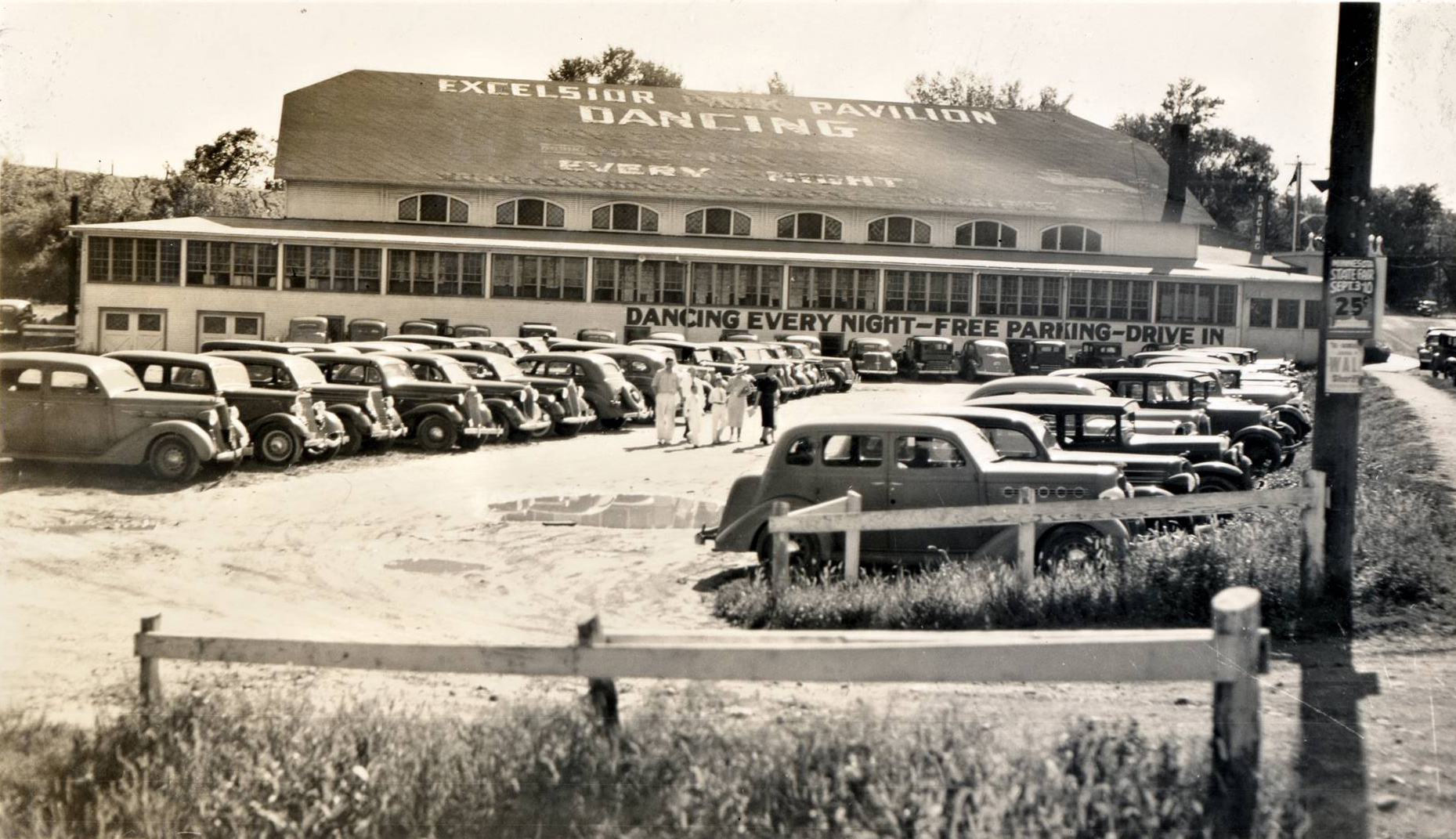
Photo courtesy the Excelsior-Lake Minnetonka Historical Society
In the 1926 off-season, roller skating took over the pavilion full time, accompanied by the “Six-piece Union Band” every Saturday and Sunday night.
1927
March 25, 1927:
McNiece Revives Roller Skating: J.E. McNiece, proprietor of the Excelsior Park Pavilion, will open the pavilion Sunday night for roller skating and will continue three nights a week through the spring and summer months. During the summer, skating will be alternated with dances three nights a week. There will be music for the skaters as well as for the dances.
April 1, 1927:
J.E. McNiece will open the dancing season at the Excelsior Park Pavilion on April 16 [with an Apple Blossom Dance]. Special music for the opening night has been engaged…. Mr. McNiece’s dances have always been clean and orderly and he says the same high standard will be maintained through the coming season.
The annual concert of the Excelsior Band took place on April 22, 1927, at the Excelsior Park pavilion. In addition to the concert numbers, “special entertainers” were promised. Proceeds went to support the band, which was directed by Mr. Carciofini.
ROLLER SKATING
The summer of 1927 schedule at the Excelsior Park Pavilion started out with dances every Saturday night and roller skating every Sunday afternoon and evening. During June, July, and August, the dance schedule changed to every Wednesday, Saturday, and Sunday night. Roller skating (also accompanied by music) was available Monday, Tuesday, Thursday, and Friday nights. In August the dances scaled back to Saturday nights only, with roller skating expanded to every night except Saturday.
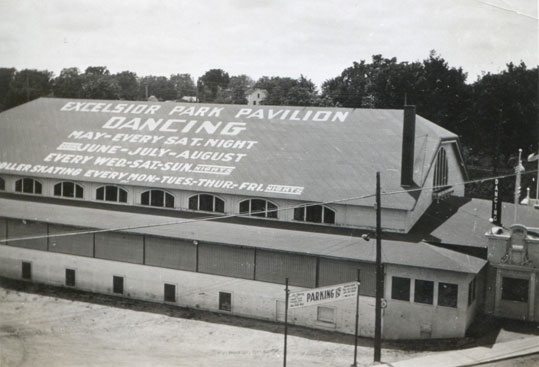
Photo courtesy Excelsior-Lake Minnetonka Historical Society
THE PICNIC PAVILION
The Amusement Park opened for the 1927 season on May 14, with new Park Manager Samuel Benjamin.
In 1927 the Park featured a new picnic pavilion that could accommodate 1,500 picnic-goers. The pavilion had no sides and was constructed on fill that had been dredged from the bottom of Lake Minnetonka. A stage was provided for speakers and performers of organizations. Concerts at the new picnic shelter were given every afternoon and evening. The building was for special events and concerts only – no dancing was done here. Admission was free.
On the stage is being installed a foremost achievement of the music world, the newly-invented auditorium orthophonic. Pearce explained:
The Auditorium Orthophonic presents singers, bands, orchestras, choruses and choirs as though the artists themselves were appearing before you. You may sit as close as you please, or you may be three miles away from the Orthophonic and in either case you will hear it just as distinctly and without distortion or mechanical sound of any kind.
Here is a photo of one found online:
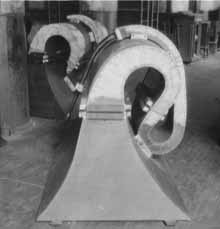
Keystone-Mast Collection, UCR/California Museum of Photography
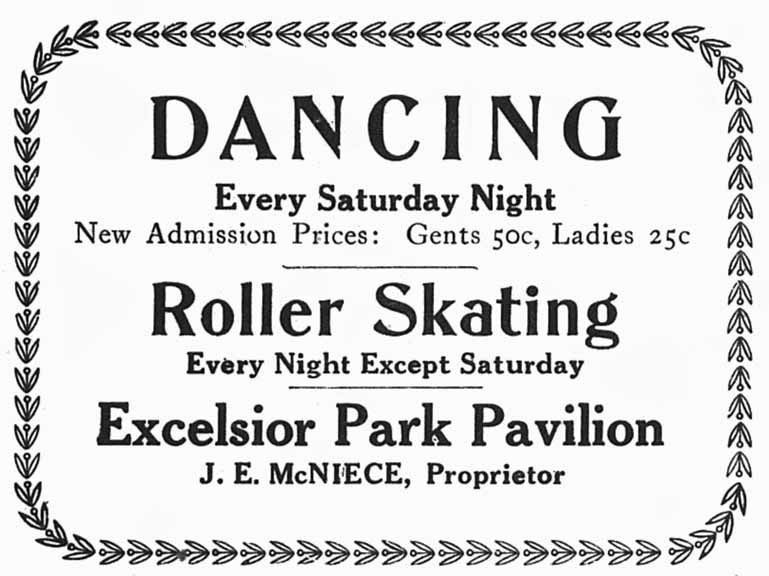
Minnetonka Record, August 6, 1927
On August 13 and 14, 1927, the Excelsior Park Pavilion hosted special dances with Hal Keller’s 8-piece Band, just back from a nine month tour. Keller was formerly with Isham Jones’ Orchestra in Chicago. New prices: Ladies 25c, Gents 50c.
A Gala Corn Carnival was held at the Park from August 21 to September 5, 1927. Every night there was a masquerade contest with a different theme each night. The ad also promised “Confetti Battles, Rube Bands, Parade of all Masqueraders, Special Added Attractions.” A new “Auditorium Orthophonic” was installed in the ballroom. It appears to be a huge speaker.
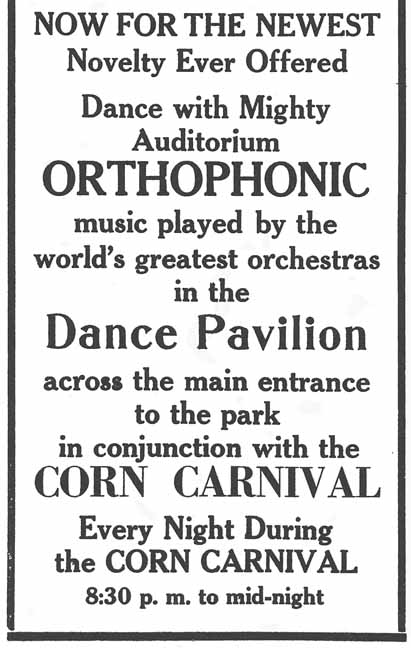
The October 1st, 1927, Saturday dance was called the Kiss Dance, with music by the Original Royal Vagabonds – Eight Master Players, Singers, Entertainers. Ladies and Gents both 50 cents. “Boys, bring your lady friends.”
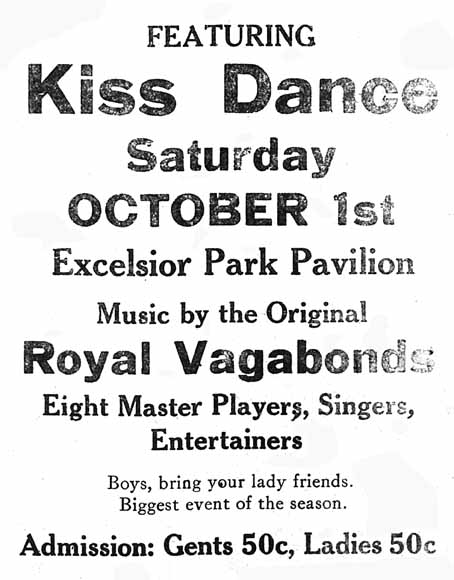
Minnetonka Record, September 30, 1927
1928
What’s this? In an ad for a basketball game between the Williams Brothers of St. Louis Park (Yea!) and Excelsior on January 18, 1928, the paper called the venue the Lake View Pavilion. There’s a missing issue of the Record, and then on January 27, 1928, it’s back to the Excelsior Pavilion. Another game between the Excelsior Firemen and the Minneapolis Business College on February 25, 1928, was described as being at the Excelsior Park Pavilion.
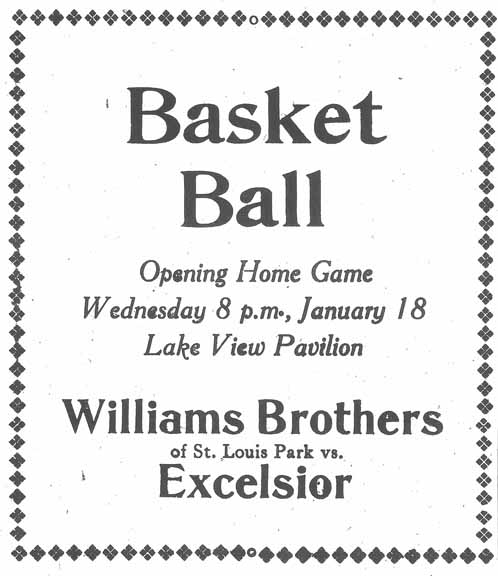
Minnetonka Record, 1928
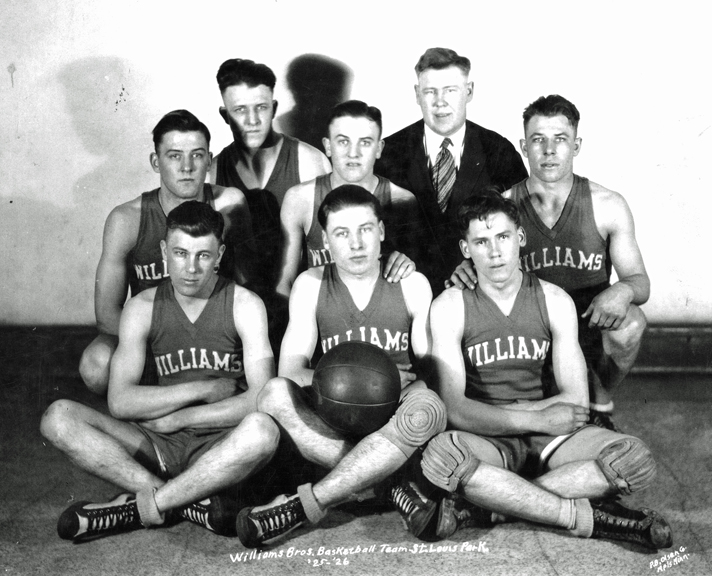
The mighty Williams Brothers Basketball team from St. Louis Park
EXCELSIOR GARDEN PAVILION
April 27, 1928:
The Excelsior Garden Pavilion, formerly the Excelsior Park pavilion, opened for the season with a dance Saturday evening. There will be dancing every Saturday Night until May 30. From then on the pavilion will be open every night throughout the season. There will be a new orchestra each week. J. E. McNiece is proprietor.
Striking effects are obtained in the decorations. The large room is made to represent a garden. In the center appears a rugged tree. From this point paths diverge in several directions. The floor is stained a forest green. The walls are treated to carry out the forest and garden effect.
An ad that same day promised: “Something New and Different. Come dance in the garden on the green. Eddie Corlew and his Aristocrats, formerly at the Merigold (sic), will furnish the music Saturday night, April 28th. Ladies 25c, Gents 50c.”
May 11, 1928:
The Excelsior Garden Pavilion, J.E. McNiece, proprietor, opened the season with all new decorations that emphasize its attractive name. The main dance hall is being transformed into a veritable garden, with simulated paths radiating from a large spreading shade tree in the center of the room. While the Pavilion has been open for more than three weeks with regular dance nights, Mr. McNiece plans to have the place in ship shape for the grand opening May 30.
The manager of the Amusement Park was Sam Benjamin.
On August 1, 1928, a gale force windstorm hit the Park, doing much damage to the rides – especially the roller coaster.
EXCELSIOR DANCING PAVILION
Having a tree in the middle of a dance floor might not have worked.
On October 30, 1928, the Excelsior Dancing Pavilion was sold at a sheriff’s sale to the Fred W. Pearce Corp., the owners of the Excelsior Amusement Park.
The new owners announce that extensive improvements will be made that will make the pavilion one of the finest ball rooms in Minnesota, and that the very best orchestras will be engaged during the summer months, which together with elaborate lighting effects will undoubtedly result in enormous crowds from the Twin Cities. (November 2, 1928)
On November 6, 1928, election returns were broadcast on the “Mighty Orthophonic,” and dancing followed. Music for the November 17 dance was provided by Wesley Barlow’s Hotel Nicollet Orchestra (Ten Pieces).
1929
The Excelsior Dancing Pavilion was used for the first time in the 1929 season on Friday, May 10, with a function held by a group of University students. The Amusement Park opened on May 11, 1929.
The dance pavilion has been re-decorated inside and out. A 10-piece orchestra, Red Clark and His Play Boys, has been engaged for the season. There will be dancing every night from May 11 on. Sam Benjamin and Fred W. Clapp are managing the park, the same as formerly. (May 3, 1929)
August 31, 1929 was KSTP Grandpa Reception Day (?) at the Park, celebrated with a Big Dance Carnival every night from August 31 to September 8. Novelties, balloons, hats, horns, and noisemakers were all provided – “Everything to make Whoopee.” Wally Erickson and His Wonderful Orchestra provided the music.
The photo below was taken from the roller coaster. Dancers had to enter in the clown/sailors’ mouths, which were made of “Celotex” and painted in oil to withstand the weather.
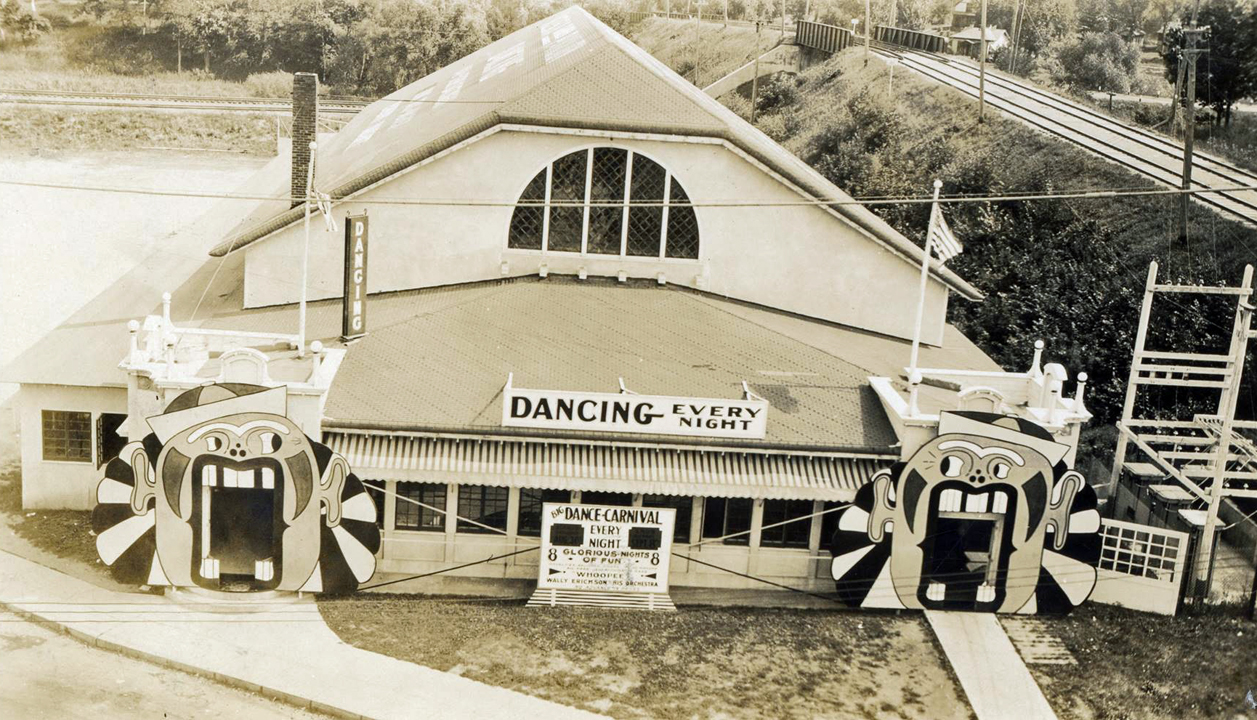
Photo courtesy the Excelsior-Lake Minnetonka Historical Society
Below, Scott McGinnis gives us an idea of how these entrances may have looked in color:
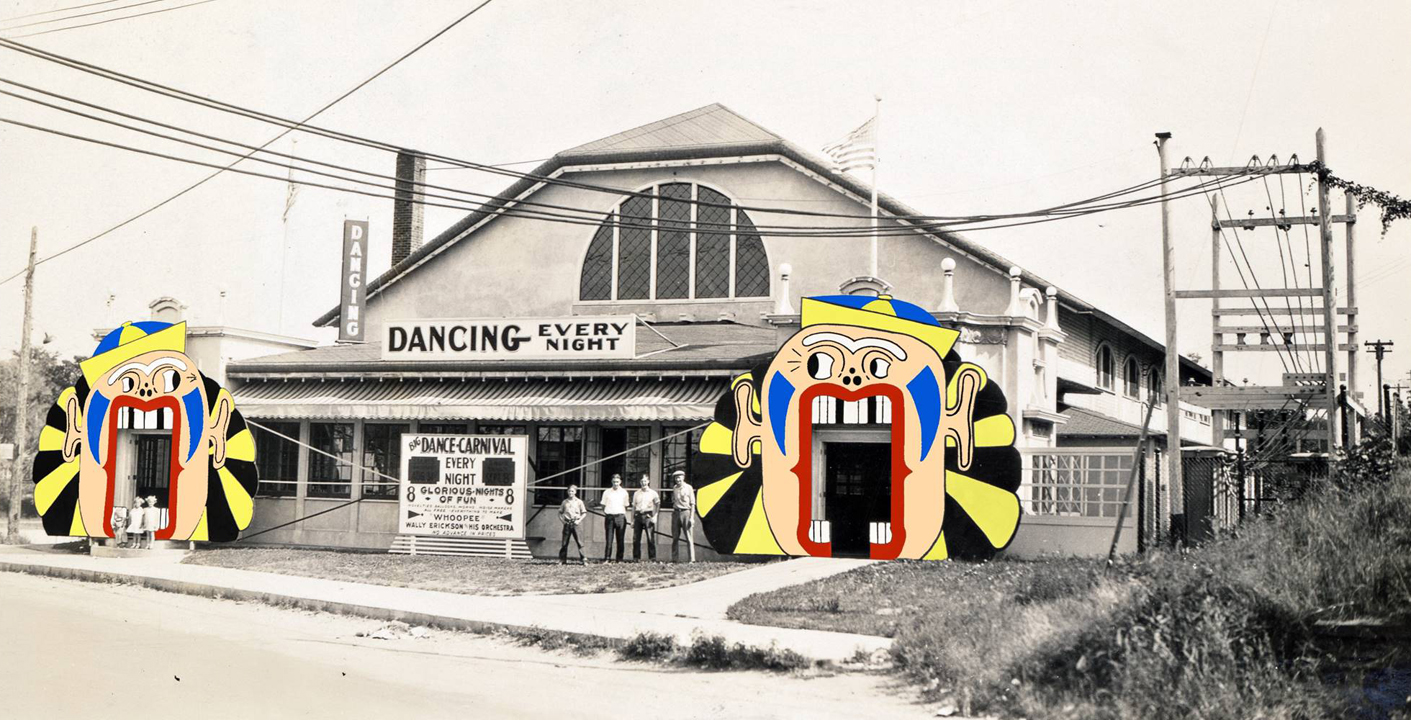
Photo courtesy the Excelsior-Lake Minnetonka Historical Society
1930
From 1930 until his death in 1957, the manager was Rudy Shogran, who is described as a “master of the promo.” One of his stunts was to provide motorcycle escorts to bring national acts performing downtown at the Orpheum out after their shows. Shogran was also in charge of booking the ballroom.
Was this a Ballroom newsletter? Were the Original Admirals the house band?
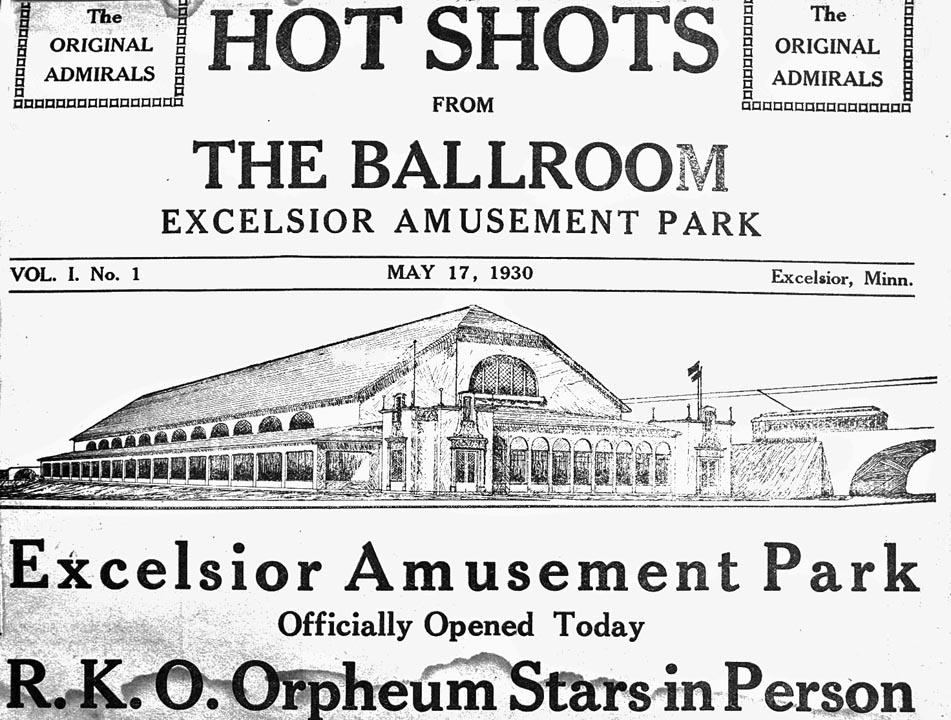
Photo courtesy the Excelsior-Lake Minnetonka Historical Society
High School Commencement Dances were inaugurated in June of 1930.
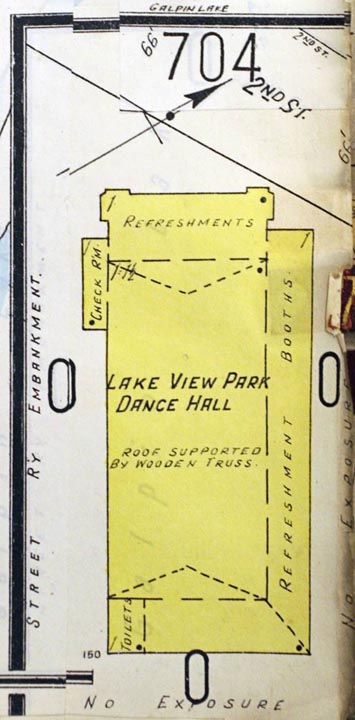
Photo courtesy Scott McGinnis/the Excelsior-Lake Minnetonka Historical Society
1931
Pre-season dances were held on May 2 and 3, 1931, with music provided by Mildred Couch and her Rosebuds.
This is a band of girls capable of doubling on several instruments; each player is an artist. The band has a long record of success on R.K.O. and Publix theater circuits in the east and in Canada. Dance and music fans will have an opportunity to hear and step to the strains of a tip-top orchestra. These girls were received as a sensation in Hollywood recently. (Record, May 1, 1931)
The review was favorable:
Mildred Couch and her famous Rosebuds captured the hearts of dancers from the surrounding territory last Saturday and Sunday at the Excelsior Amusement Park Ballroom. In a stage setting of delicate feminine taste and surrounded by soft lighting incandescents, the girl’s band registered a distinct hit on their first opening dance. Their rhythm together with the rendering of splendid dance music no doubt will bring hundreds to the ball room for the next appearance next Saturday and Sunday nights. (Record, May 8, 1931)
The ballroom was being overhauled for the official opening on May 16, 1931.
Large and small stars electrically lighted in the ceiling of the ball room will make a beautiful setting for the many dancers who patronize it. The famous Rosebuds will furnish the music for dancing. (Record, May 15, 1931)
The season officially opened on May 16, 1931.
Starting June 6, the Park engaged Fran Whalyn and His Orchestra for a 10-week stint, direct from a similar engagement in Oklahoma City.
Chock full of pep, personality and rhythm, this orchestra has made a big hit at every engagement and the management of the park feels there is a treat in store for dancers from this locality who attend their opening night. (Record, June 5, 1931)
The second Annual High School Commencement Dance was held on June 11, 1931.
The July 4 fireworks were rained out, but the Park made up for it on Sunday, July 12. A special dance was held that night featuring Wally Erickson’s Orchestra, with Ray Kopstad directing.
Starting on July 6, 1931, the Wally Erickson Orchestra provided the music in the ballroom. They came direct from an engagement at the Marigold Ballroom.
Rudy Clemmenson’s Orchestra provided the music at the ballroom on August 30 and for a special Labor Day dance on September 7.
On September 13, 1931, there was a special event – the public wedding of Michael Wrona and Beatrice Prevost. The nuptials were held at the picnic pavilion, with the Park providing wedding cake, souvenirs, and “rice for the charivari.” It was followed by a wedding dance in the ballroom with music provided by Rudy Clemmenson’s Orchestra, which was playing at the ballroom at the time.
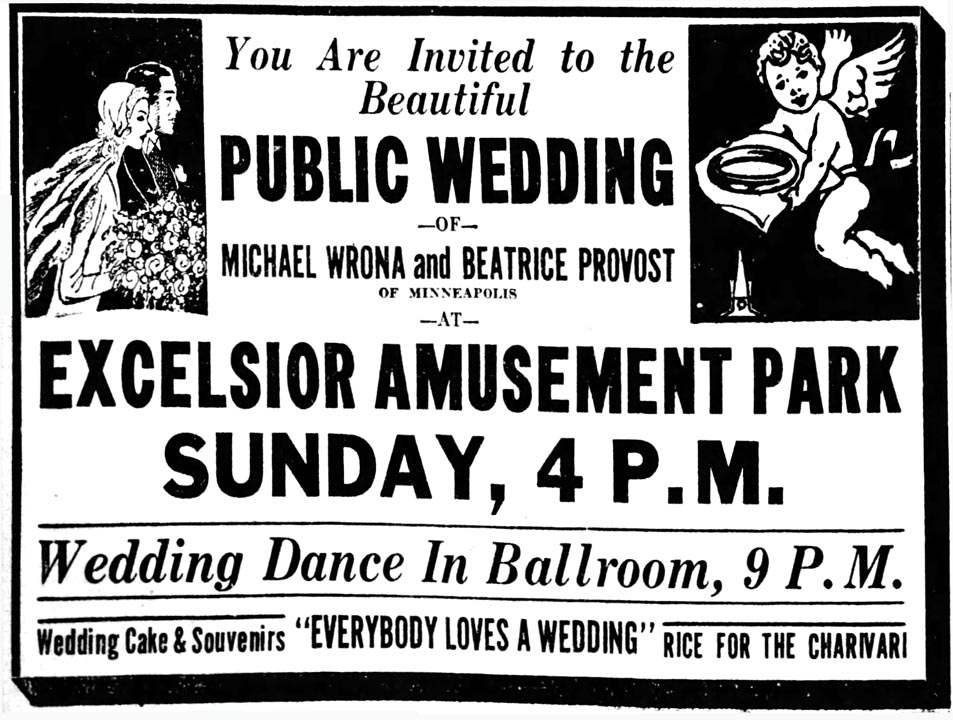
On New Year’s Eve, 1931, the Excelsior Firemen sponsored “A Carnival of Joy” at the ballroom, featuring Mildred Couch and Her Rosebuds. Admission for Gentlemen was $1.00, but Ladies were in for 50 cents. “In all the world no party like this”
1932
Pre-season opening of the Excelsior Amusement Park was Saturday, April 30 and Sunday, May 1, 1932. Music in the ballroom was provided by Rudy Clemmenson and his St. Paul Athletic Club Orchestra. The orchestra had been increased to 11 pieces during it winter broadcasts over WCCO Radio.
A second pre-season opening was announced for May 7 and 8, 1932, with Rudy Clemmenson’s orchestra, “which has become the most popular orchestra in the northwest today.”
The official grand opening for the year was scheduled for May 14 and 15. “Happy Days Are Here Again!”
Special dancing with Rudy Clemmenson’s Orchestra was advertised for Sunday, May 29 and Decoration Day, 1932. The Park was advertised as “The Playground of the Northwest.”
In June 1932 there was dancing every night “at the big pavilion.” Was this the picnic pavilion or the ballroom?
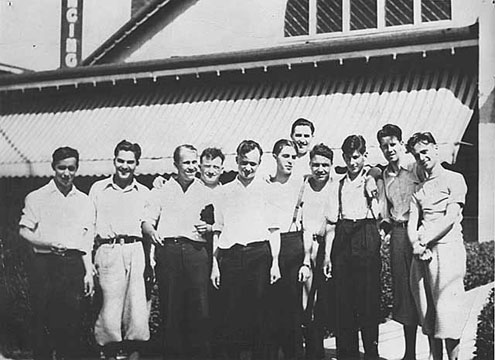
Rudy Clemenson and His Gold Coast Orchestra, taken at the Excelsior Ballroom on June 30, 1932 – courtesy Minnesota Historical Society
Joe Cappo and his Egyptian Serenaders opened their four week engagement at the ballroom on July 4, 1932.
This orchestra consists of an aggregation of musicians who have toured from coast to coast and recently appeared at Atlantic City pier. They promise a big dance program for their opening night and special July Fourth dance from 9 to 1 am. (Record July 1, 1932)
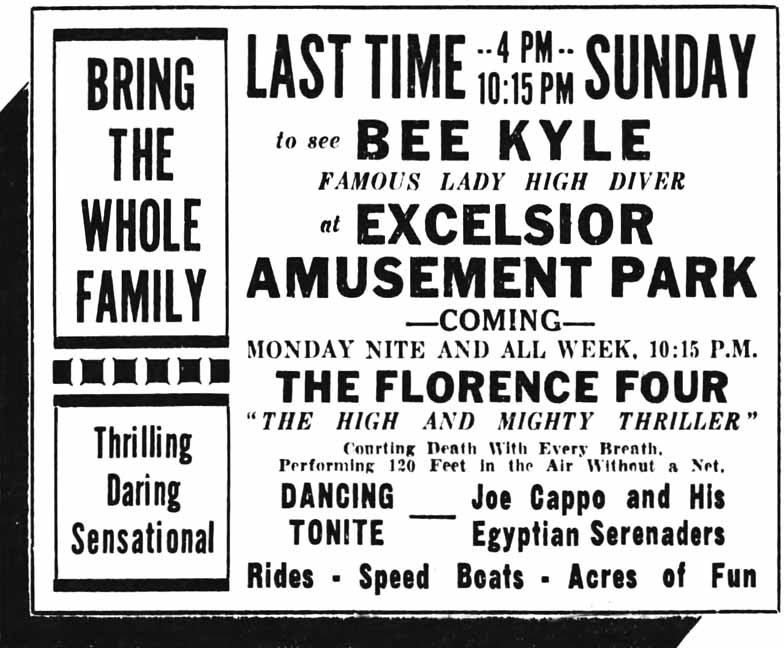
StarTribune, July 16, 1932
Rudy Clemmenson was brought back to provide the music in the ballroom in August, and remained for the rest of the season. On August 28, a special dance on the night Mystery Girl parachuted 5,000 feet into the lake went until 1 am.
Labor Day 1932 (September 5) promised fireworks and special dancing with Rudy Clemmenson’s Orchestra.
The “Famous Annual Harvest Jamboree” was advertised for the Ballroom on Friday, September 8, 1932.
In 1935 it was mentioned that Lou Breeze’s orchestra had been received enthusiastically three years ago.
And then there’s this – a Chinese wedding, complete with Antiquated Chinese music? This event on September 18, 1932, marked the last Sunday of the season. It is unclear where in the Park this event was held.
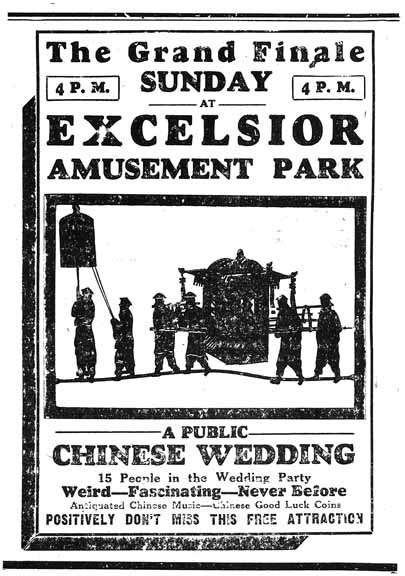
Minnetonka Record, September 16, 1932
The last streetcar ran to Excelsior in August 1932. This was about when Highway 7 came through the area and the area was becoming more of an auto-based economy. Since the power (direct current) for the Park came from the trolley lines, new motors with alternating current had to be installed over the winter and spring. (Record)
1933
Pre-opening dances were held Saturdays and Sundays before the official opening on May 13, 1933.
Not sure what The Reminder was, but here is a reminder to come to Reminder Night at the Excelsior Amusement Park Ballroom, May 23, 1933:
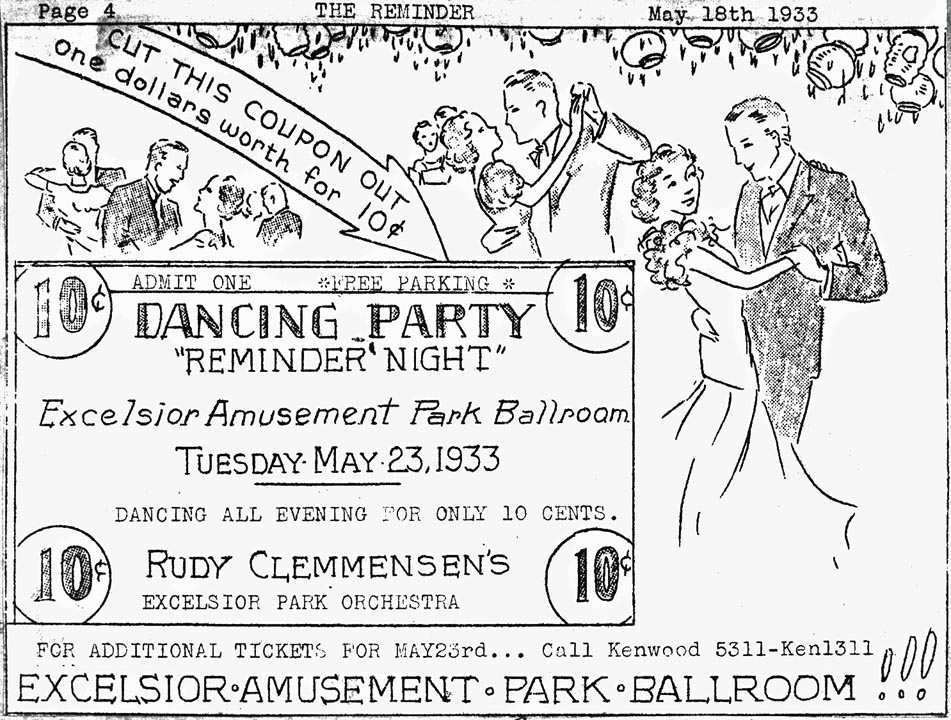
Image courtesy the Excelsior-Lake Minnetonka Historical Society
June’s orchestra was led by ballroom favorite Rudy Clemmenson, whose unit now numbered 12 members. The orchestra also presented public concerts at the picnic pavilion on Sundays from 3 to 5 pm.
Dancing was offered every night during the summer. The July 4 dance was free of charge, with music by Clemmenson’s group.
WCCO radio broadcast the music from the ballroom every Tuesday and Friday evening. The radio station also sponsored a WCCO night on August 2, 1933, featuring Tim and Teena and the rest of the station’s personalities.
With the end of Prohibition, events manager Rudy Shogran noticed that attendance at the ballroom was not as heavy. To investigate why, he visited the “honky-tonks” that line Excelsior Blvd. from Excelsior to Hopkins. He found that they drew patrons who were “drunken, loud, talking, and slopping of beer.”
On September 1, 1933, an armed man entered the ballroom brandishing a gun. As panic ensued, the armed man also fled in his car, not hurting anyone. He was picked up the next day with an empty bottle of alcohol in his car.
September 10, 1933, was the official closing date for the Park for the year.
1934
Excelsior Park held its pre-season opening on May 5 and 6, 1934, with dancing to George Ganz and His Golden Gate Orchestra.
The official opening of the Park for the season was on May 12 and 13, 1934, with music in the Ballroom by Frank Gordon and his Orchestra with Gertrude Carpenter.
Frank Gordon and His Orchestra were held over for a second week at the ballroom by request.
Wally Erickson and his 11-piece orchestra provided the music in the ballroom for the week of May 19, 1933. ?
July 4 was so busy at the Park that provisions had to be made for all the cars:
Highway 7 was closed until late in the evening when representatives of the highway department permitted the removal of the detour signs so that the cars could partially be routed by way of the high school building over the highway, which has been closed to traffic for three weeks. (Record, July 6, 1934)
Red Sievers and his Orchestra started an engagement at the ballroom on Saturday, July 14. “This orchestra is well known to the dance populace of the Northwest, having appeared at the Marigold Ballroom in Minneapolis for eight months.” (Record, July 13, 1934)
WCCO ARTISTS’ FROLIC (Record, July 13, 1934) This event was probably held at the picnic pavilion.
Thursday, July 19, WCCO Artist Bureau will present an all-star bill of frivolity at the Park. Fifty entertainers, including specialty dancers, a large chorus of girls, a 15-piece orchestra, several novelty acts, as well as prominent members of the Minneapolis baseball team will headline the program starting at 9 pm and running till 1 am. The entire program is under the direction of Al Sheehan, prominent Northwest radio personality, and will be known as the WCCO Artists’ Frolic.
Rehearsals for this all-star presentation have been conducted for the past week and will continue through until the night of the frolic. Jack Malerich’s well-known radio orchestra, which has been sought by the Columbia Broadcasting System for national programs, will feature with dance music and also play for the complete stage show. Malerich’s orchestra has been heard over WCCO on the Pure Oil program nightly for the past nine months and has risen to the honor of being the best orchestra in the Northwest at the present time according to a recent radio poll conducted in this section of the country.
Among some of the well-known individual artist who will appear will be “Twenty Flying Fingers,” two piano teams made up of Ramona Gerhard and Bee Bailey; and the banjo twins, Ham and Jim, who have done “rube” acts and black face comedian stunts. Both these acts have been featured on the Non Headlights over WCCO for the past eight months. In addition other individuals will include the Four Horsemen, male quartet, and the triple threats.
Among the leading baseball personalities will be Halsey Hall, sports announcer, as well as a number of prominent Minneapolis players. Al Sheehan, nationally known for his work over the CBS System, will be master of ceremonies. This all-star program will be augmented by the Park’s regular entertainment features.
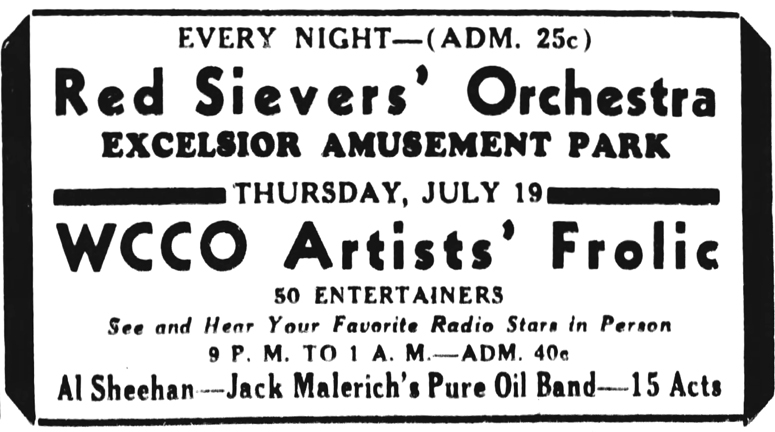
“The annual WDGY radio show was scheduled for August 8, 1934. “It will include all of the WDGY radio stars in person, with a floor show and dance music.” (Record, August 3, 1934) Probably at the picnic pavilion.
“Wally Erickson and his orchestra appearing for a return engagement are playing to large crowds with dancing every night.” (Record, August 3, 1934)
Frank Gordon and his orchestra began a two week engagement on August 18, 1934. Featured vocalists were Gertrude Carpenter and Ted Pomerleau.
A 50-member banjo band led by Mr. C.W. Gould graced the picnic pavilion stage on August 19, 1934, for two appearances at 3:30 and 8:00 pm. Gould’s organization won the national championship of banjo bands three years in a row!
DAISY AND VIOLET HILTON
On Saturday, September 1, 1934, famed “Siamese twins” Daisy and Violet Hilton came to the Park, complete with their own 14-piece orchestra. At the time they were thought to be the only conjoined twins alive. The twins sang, danced, and played instruments. It is unclear where in the Park they performed. One source says that the girls directed the group, and another says it was directed by Morris Lambert, who was engaged to one of the twins.
A problem arose when Violet decided she wanted to marry Mr. Lambert, a trombone player in their orchestra. The lovestruck couple tried to get a marriage license in each town they appeared in but were denied on the grounds that the man would be marrying two women and that, my friends, is bigamy. An article in the Minneapolis Journal warned the Clerk of the District Court that they would be trying again when they came to town! The story of this unsuccessful attempt at marriage (and two successful but ultimately undone marriages) is told in this article.
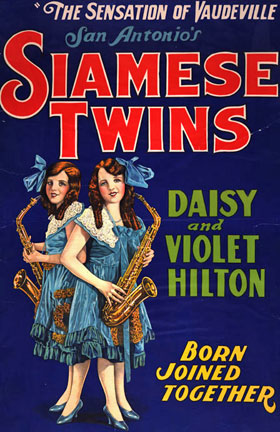
1935
Excelsior Amusement Park had its pre-season opening on April 27 and 28, 1935, with music by Wally Erickson and His Orchestra. “The management will continue the present policy of offering the foremost dance orchestras in the northwest at popular prices.” (Record, April 26, 1935)
The following weekend, May 4-5, 1935, music was provided by Rudy Clemenson and His Orchestra.
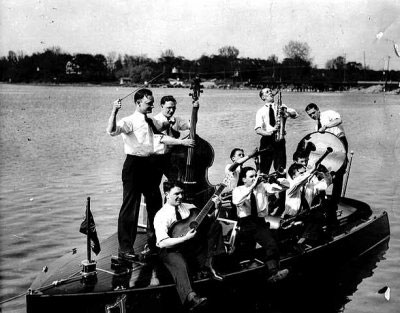
Rudy Clemenson and His Orchestra on Lake Minnetonka – Minnesota Historical Society
The Grand Opening of the Park took place on May 11 and 12, 1935. The Clemmenson group was engaged for the opening and the week after. It was noted that they had recently appeared at the Curtis Hotel and the St. Paul Athletic Club. (Record, May 10, 1935)
May 18-27, 1935, featured Norvy Mulligan and His Orchestra, Direct from the Radisson Hotel, Minneapolis. The band was featured on NBC radio while appearing at the Radisson. (Record, May 17, 1935) Mulligan’s professional career began in 1923 while attending the U of M. His first professional job was at Excelsior Amusement Park. He went into the insurance business in 1936.
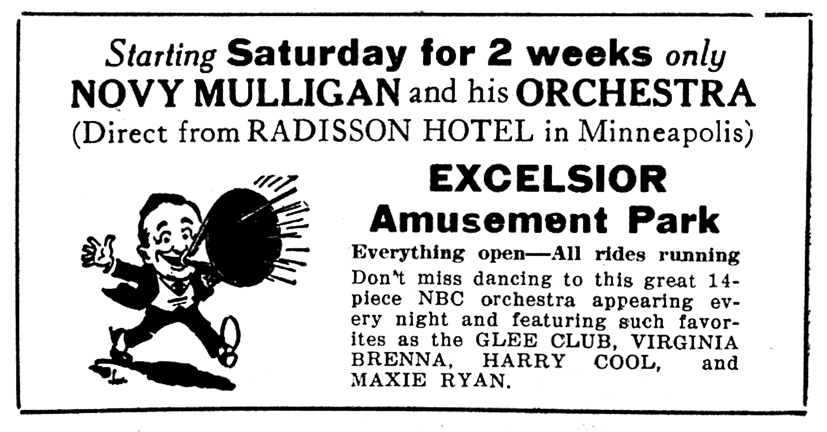
That should be NORVY.
Popular features included:
- Song and dance team Maxie Ryan and Mary Johnson
- Harry Cool and Ray Kammerer, whose interpretation of “Popeye the Sailor” was considered a musical comedy classic
- The Glee Club
- Virginia Brenna
By popular demand, Norvy’s band was held over another three weeks. (Record, June 7, 1935)
The 12th Annual Commencement Dance was held on June 6, 1935.
WCCO REDUX
June 14, 1935, was a repeat of last year’s WCCO show, featuring 40 entertainers. The program was presented from a specially designed and illuminated stage in the ballroom. (Record, June 14, 1935)
Performers included:
- Tena of Tena and Tim
- A 14-piece dance orchestra
- Halsey Hall
- Prominent members of the Minneapolis baseball team.
- The Fels Foursome and Arlene Johnson
- John Williams and Elsa June
- The program was under the direction of Al Sheehan, popular Northwest radio personality. (Hennepin County Review, June 14, 1935)
- Dance music by Norvy Mulligan, “intermingled”
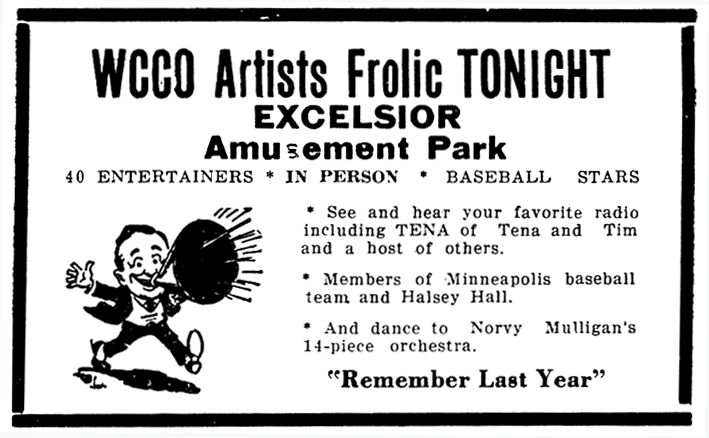
The orchestra at the end of June and much of July 1935 was that of Frank Gordon, with vocalist Gertrude Donohue. The ballroom was described as air conditioned on July 20, 1935.
Joe Cappo and his Egyptian Serenaders opened a week’s engagement on August 3, 1935. It appears that they were held over until September 8, the official closing night of the regular Park season. (Record, September 6, 1935)
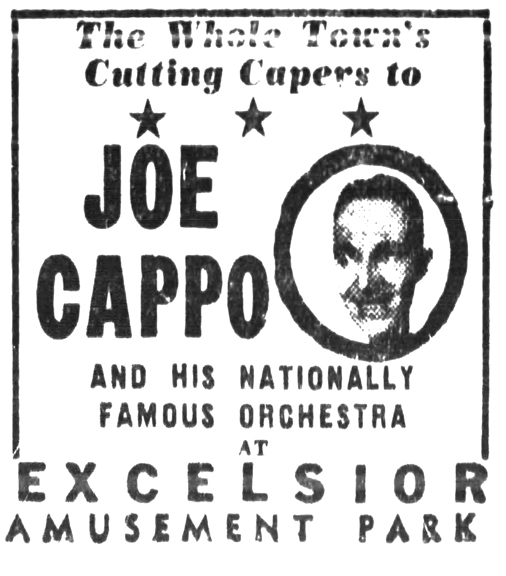
John Ganley was named as the Ballroom’s manager in the August 2, 1935, article.
On August 4, C.W. Gould returned with his 50-piece banjo band for two free concerts at the picnic pavilion. Since the band’s appearance the year before, it won yet another national banjo band championship! (Record, August 2, 1935)
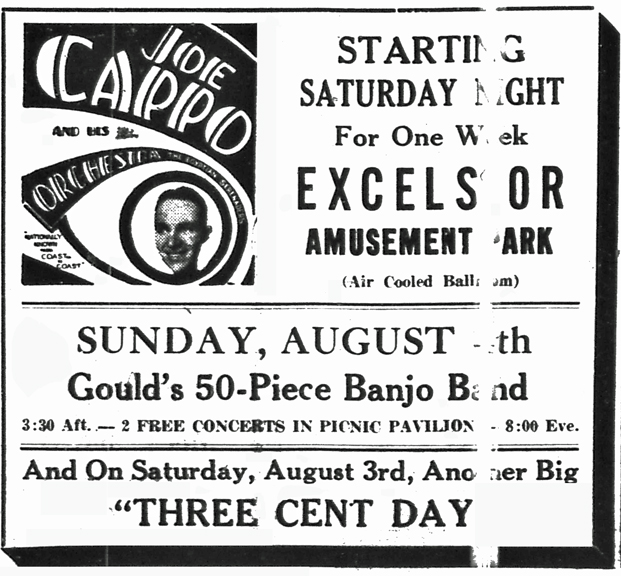
August 9, 1935, was the WDGY Artists’ Show, featuring your favorite WDGY radio entertainers in person and the Joe Cappo Orchestra. (Hennepin County Review)
Must have been a warm fall in 1935, as the Park was open on September 20 for a Dance with the Queen of Apple Day, Excelsior’s annual celebration. Bill Hulwi’s Orchestra provided the music.
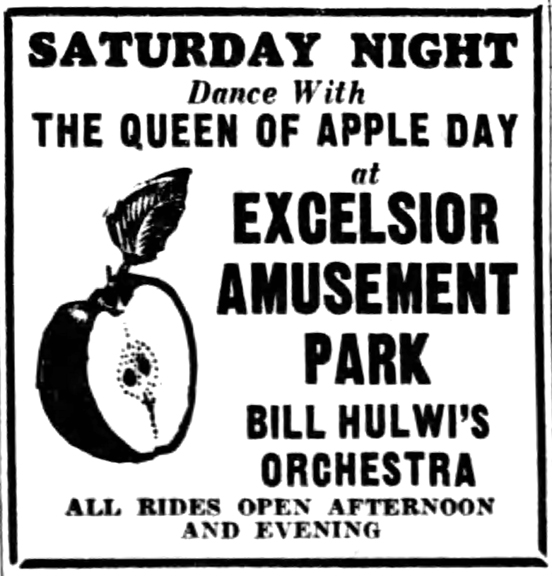
September 20, 1935
1936
Norvy Mulligan was back, and played for the Annual Commencement dance, held on June 4, 1936.
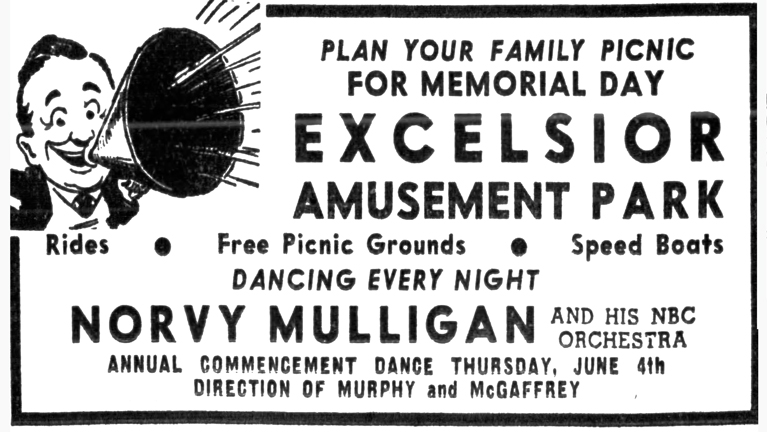
1937
The 1937 pre-season opening of Excelsior Amusement Park was April 24, 1937, with music by Bud Strawn and His Orchestra. The Grand Opening of the Excelsior Park Ballroom was Friday, May 21, 1937, with dancing nightly thereafter. Music was provided by Bud Strawn and by Phil Lavant and His Orchestra (April 30 to May 2 only). The Twin City High School Night was held on May 14.
Rudy Shogran noted in his journal that “Saturday nights are sure different with the young folks and drinking and the new truck dance.” The practice of cutting-in had also developed, which was annoying to many of the dancers.
One night Shogran noted that the band had drawn a bunch of kids who trucked and raced around, and that the ones who trucked were “of a different class of people.”
Gould’s 60-piece Banjo Orchestra provided entertainment in 1937, as well as a Battle of the Bands between Joe Billo’s swing band and Whoopie John’s polka band. There was an Apple Day dance in the ballroom, and the crowning of the Apple Day Queen in the picnic pavilion.
1938
The ballroom established a new policy of providing new and better bands, changing them out every two weeks, and hiring big-name bands for one-night stands in the summer.
The Park opened on May 14, with Hal McIntyre and the MAC Gopher Orchestra in the Ballroom. The Orchestra had been performing at the Lowry Hotel. All ladies attending the opening dance received a free rose.
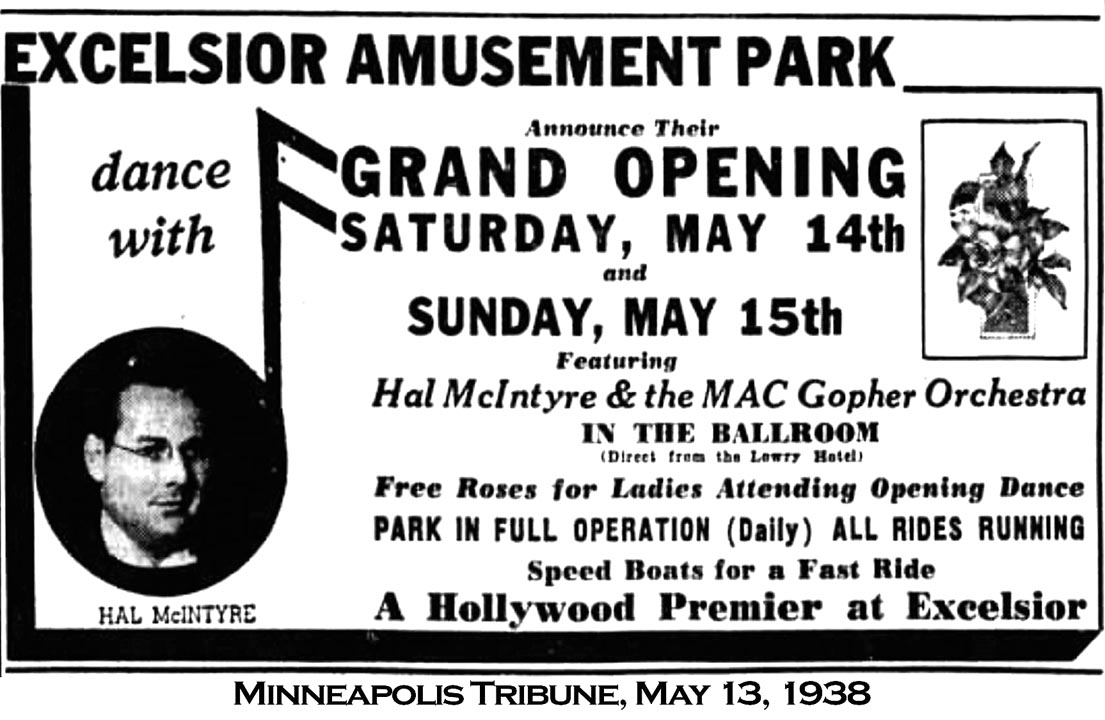
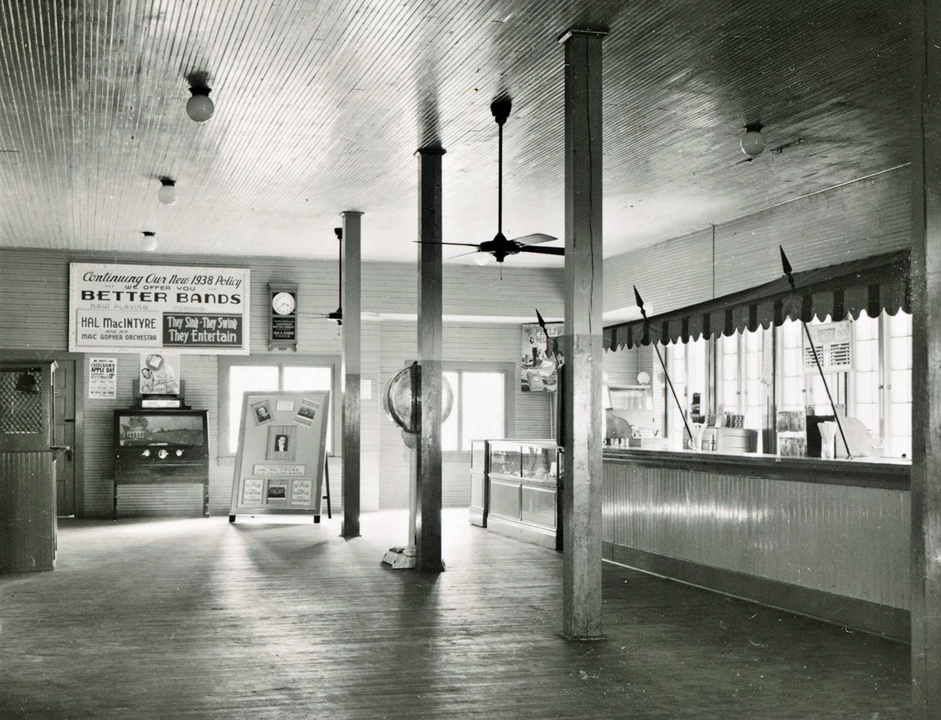
Concessions area, conveniently identified as 1938! Photo courtesy the Excelsior-Lake Minnetonka Historical Society
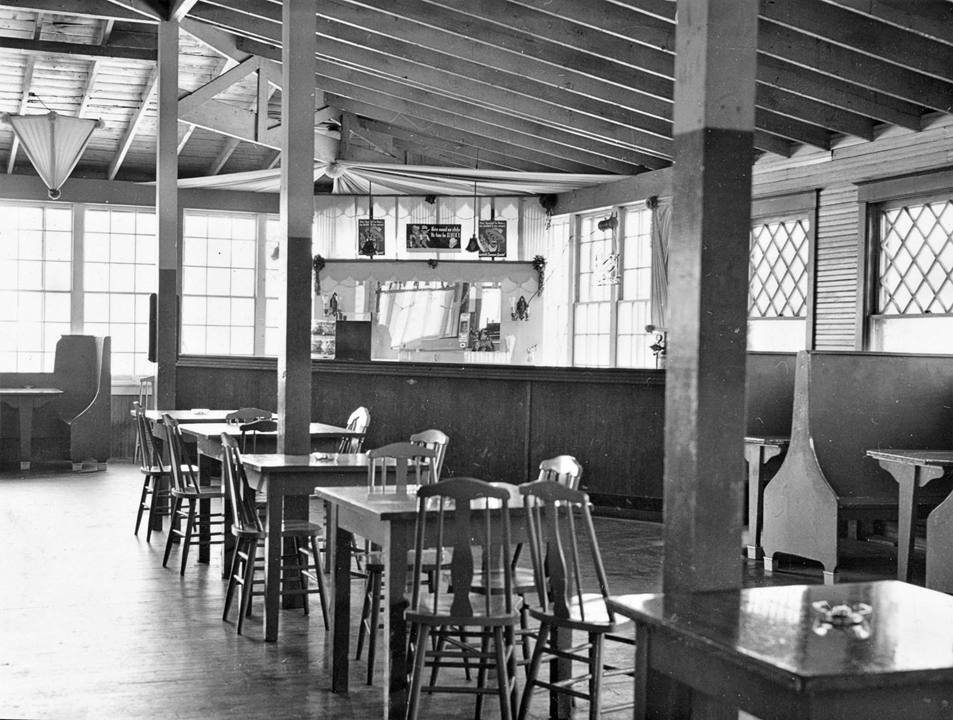
Photo courtesy the Excelsior-Lake Minnetonka Historical Society
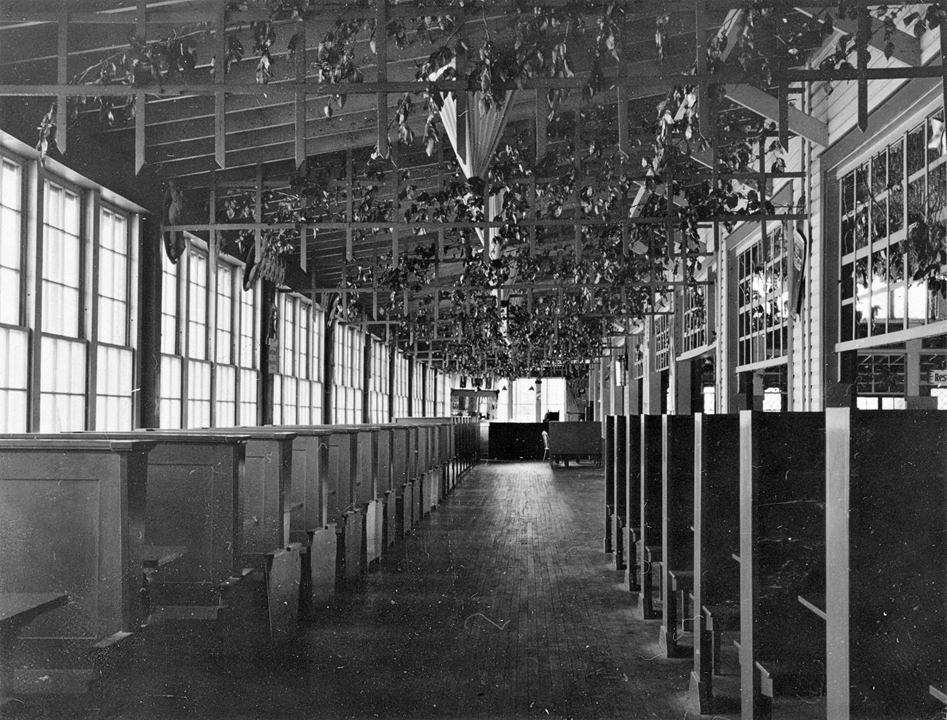
May be a 1938 photo as well. Photo courtesy the Excelsior-Lake Minnetonka Historical Society
Gould’s Banjo Orchestra returned for a repeat performance in 1938, featuring drum majorette Miss Ann Bennett.
1939
In 1939 the park began to sponsor a Twin City High School Night, featuring a dance band in the ballroom and free rides. Thousands of kids would converge on the park, with special transportation arranged. The first High School Night took place on May 17, 1939, with music provided by Jimmy Pidgeon’s Campus Band.
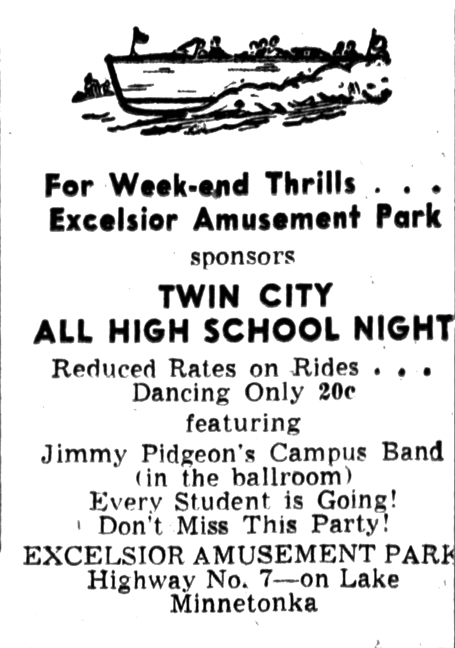
Minneapolis Star, May 19, 1939
The Park was also still sponsoring the annual Commencement Dance for all graduating seniors. The 1939 Dance was held on June 8, with music by visiting band Tom Gentry and His 12 Ambassadors – “Radio’s Royalty of Rhythm.”
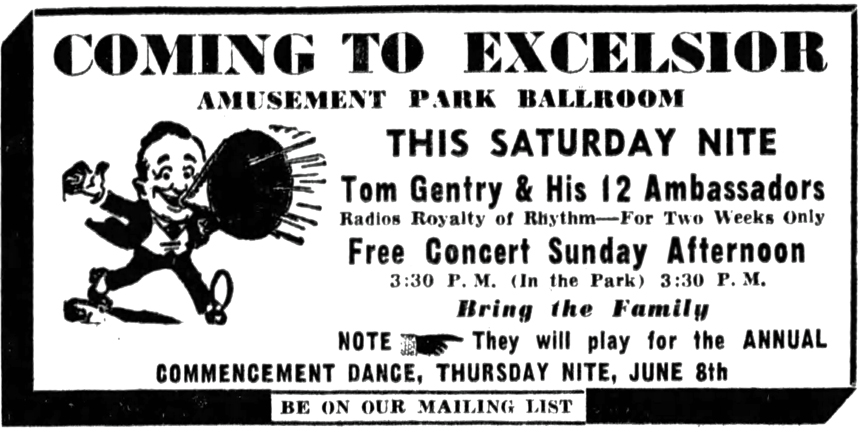
1940
The Park opened on May 17, 1940.
The Twin City High School Night took place on May 24, 1940, with music by Tiny Hill and His Orchestra.
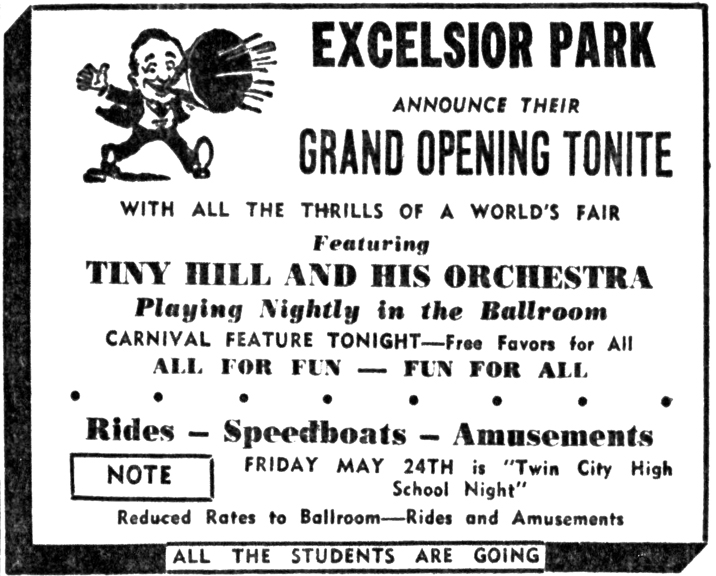
The 1940 Commencement Dance was on June 6, again with Tiny Hill’s Orchestra.
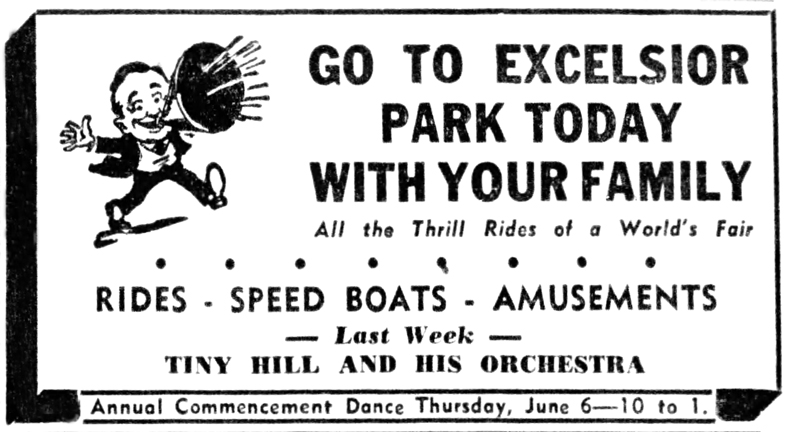
Minneapolis Star, June 2, 1940

Image courtesy the Excelsior-Lake Minnetonka Historical Society
1941
The Annual Twin City High School Night took place on May 16, 1941.
Lawrence Welk performed twice during the 1941 season. The first was on May 21.
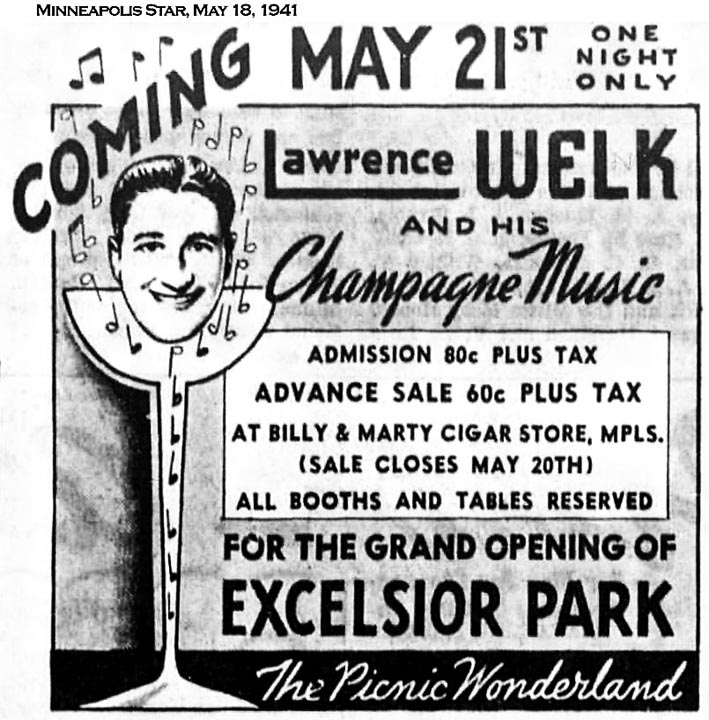
Image courtesy the Excelsior-Lake Minnetonka Historical Society
The annual Commencement Dance took place on June 5, 1941.
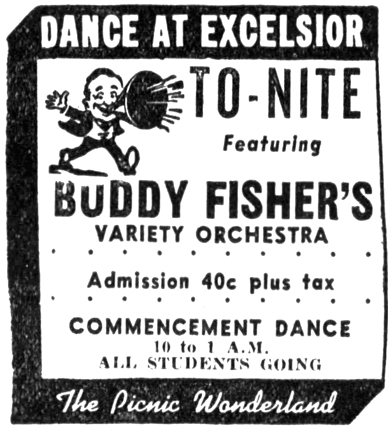
June 5, 1941 – Minneapolis Star
Lawrence Welk’s second performance on July 23 drew 814 people despite 100-degree heat. (Billboard, August 9, 1941)
The popular Glen Gray made an appearance at the ballroom with his famous Casa Loma Orchestra on July 30, 1941. Featured soloists were Kenny Sargent, “Pee Wee” Hunt, and Sonny Dunham.
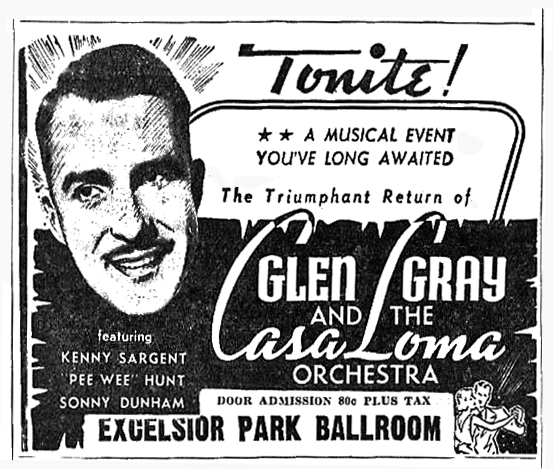
The Andrews sisters, Maxine, Patty, and Laverne, made a one-night appearance at the Park on Friday, August 22, 1941, accompanied by Joe Venuti and his orchestra. The Star reported that they planned to visit their home town of Mound during the trip. (They were born in Mound but raised in North Minneapolis.) A special plane was chartered to bring them to Minneapolis from an engagement in Chicago.
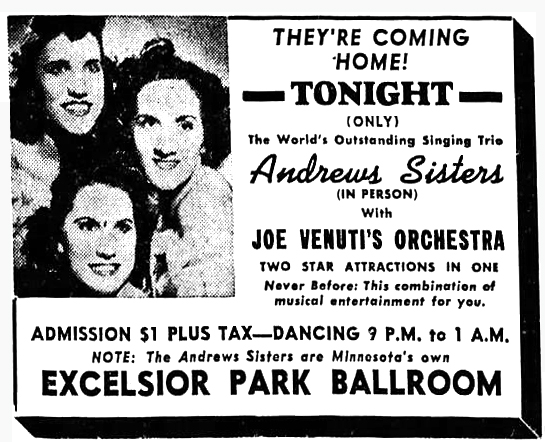
Minneapolis Star
Ace Brigode and His Virginians – A 5-Star Dance Band – appeared for a return engagement by Popular Request at the Excelsior Park Ballroom on September 12-14, 1941, the 14th being the last dance of the season. The Park’s last day of the season was September 21.
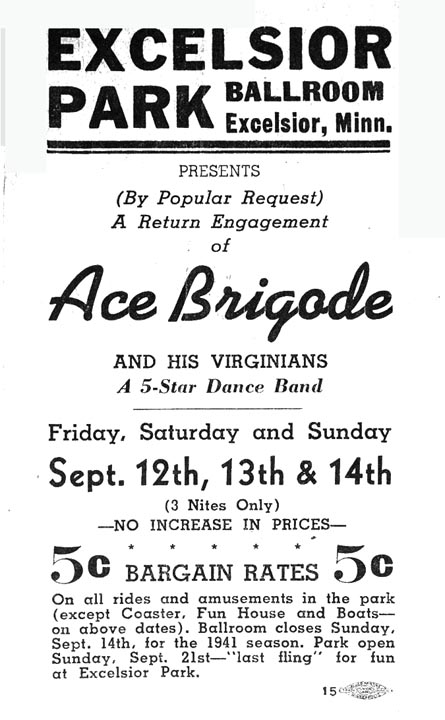
1942
Ace Brigode and His Orchestra (“Your Favorite Name Band”) appeared at the Park’s Grand Opening on May 15, 1942.
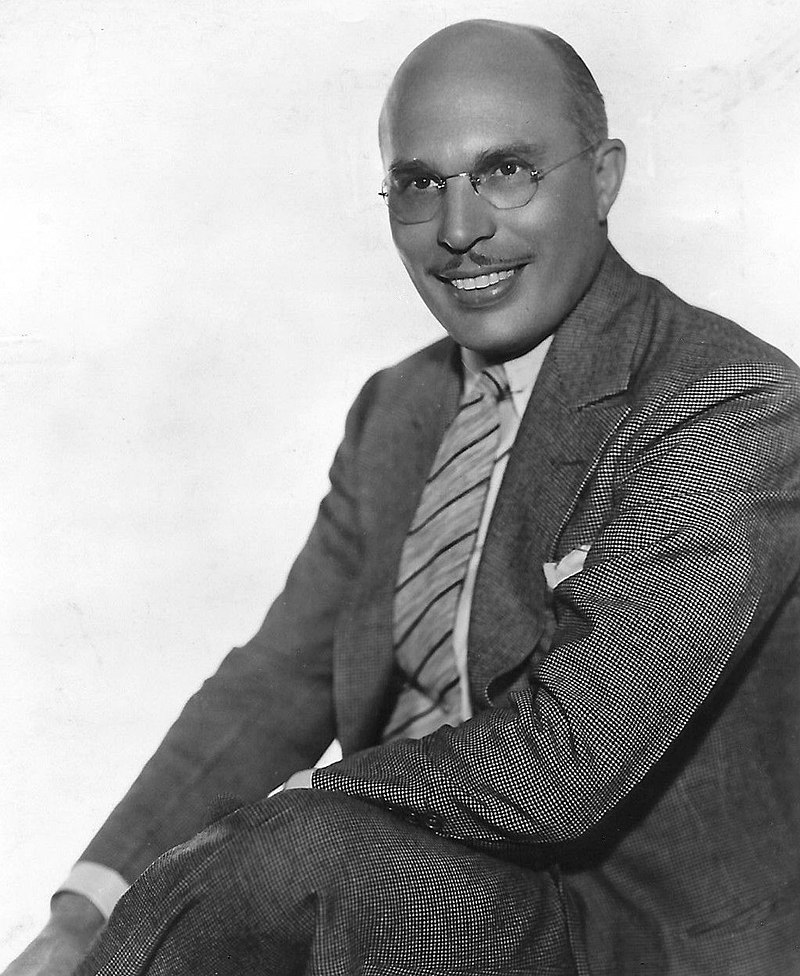
Ace Brigode, 1938. Photo by Maurice Seymour via Wikimedia Commons
May 15, 1942, was also the Third Annual Twin City High School Fun Nite. Bud Strawn was the popular orchestra leader. Dancers were encouraged to get there early with a “Beat the Clock” promotion.
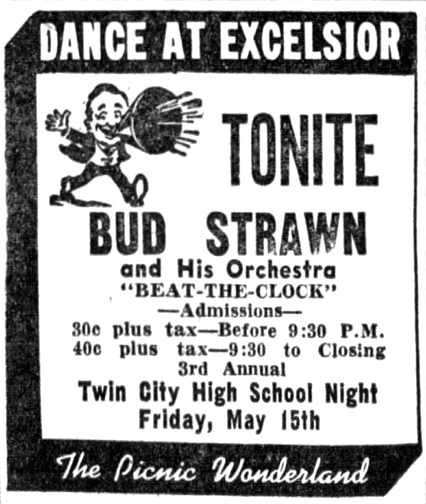
May 15, 1942 – Minneapolis Star
Ace Brigode provided the music for the annual Commencement Dance, June 4, 1942. It was the last day of his two-week engagement.
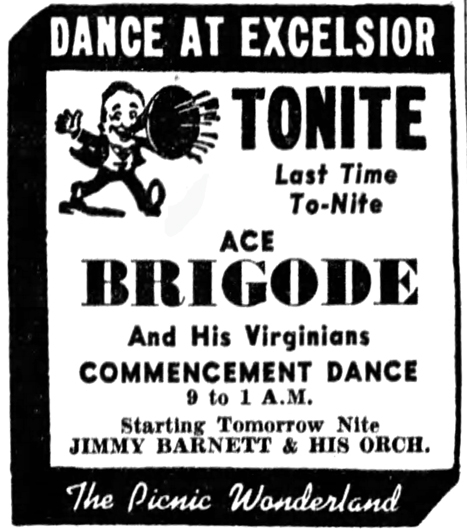
June 4, 1942 – Minneapolis Star
Excelsior Park Ballroom presented Jimmy Barnett and His Orchestra from June 5 to 11, 1942, “Dispensing Dance Rhythm As You Like It.”
Cliff Keyes and His Orchestra began an engagement on June 12, 1942.
Lawrence Welk and His Champagne Music was the featured attraction at the Excelsior Park Ballroom on June 16, 1942. Featured were songstress Jane Walton and Jerry Burke on the electric organ. All for 66 cents! Advance tickets could be obtained at Billy and Marty’s Cigar Store in Minneapolis. (Shopping News, June 11, 1942)
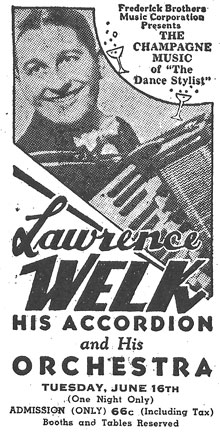
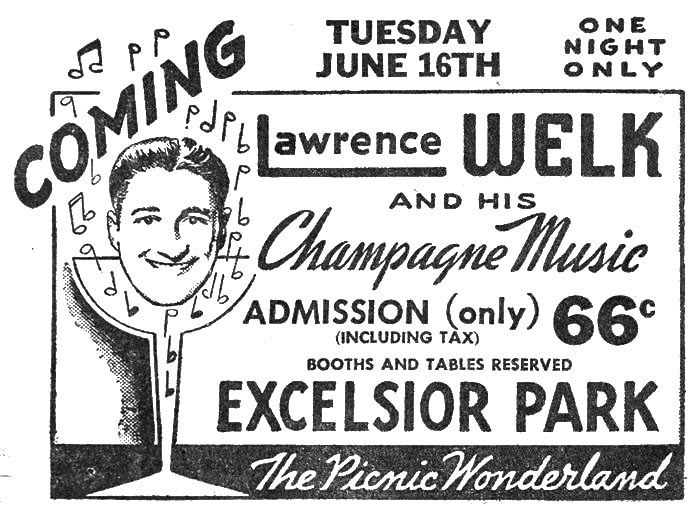
Image courtesy the Excelsior-Lake Minnetonka Historical Society
After the Welk show, Cliff Keyes and his orchestra returned for dancing.
JITTERBUG CONTEST
On June 30, 1942, the ballroom held a “boogie woogie contest.” The caption for this photo from the Minneapolis Star reads, “These four jitterbugs practice the stomp on the highway leading to Exxcelsior while deputy sheriff A.X. (Bud) Schall warns them that highway dancing is not permitted. The student dancers chose the wide open spaces to polish up in preparation for the [contest]. They are (left to right) Philip Turgeon, Marlene Ramsey, Neil Schuknecht (with phonograph), Kenny Landgran and Marlynn Swift.
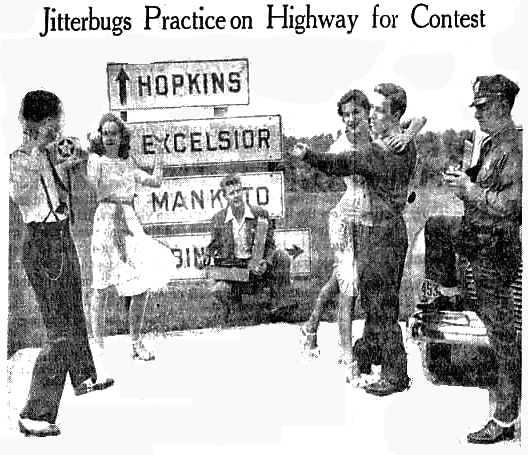
Army-Navy Benefit Day took place on August 20, 1942, with proceeds donated to the Army Emergency Fund and the Navy Relief Society. The day’s festivities ended with an Army-Navy Ball in the Ballroom.
The photos below are undated, but give a wonderful peek inside the ballroom when she was all dressed up – perhaps for a special dance, or for New Year’s Eve?
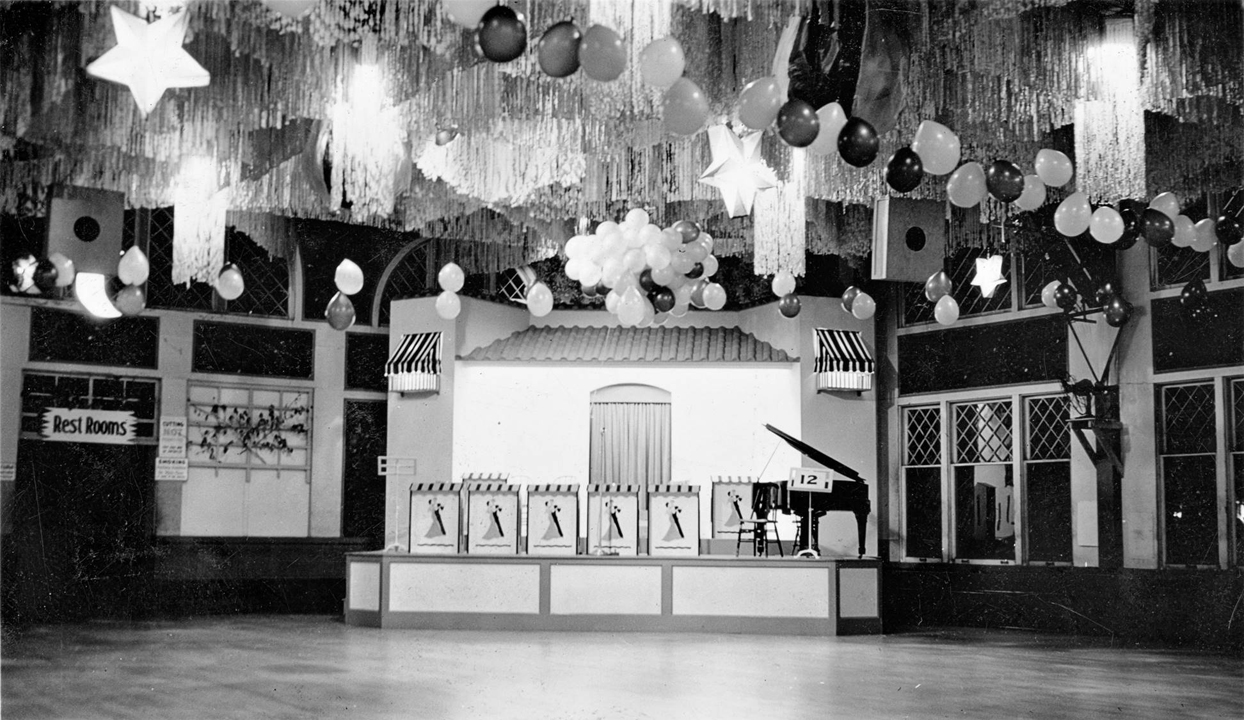
Bandstand in the back. Photo courtesy the Excelsior-Lake Minnetonka Historical Society
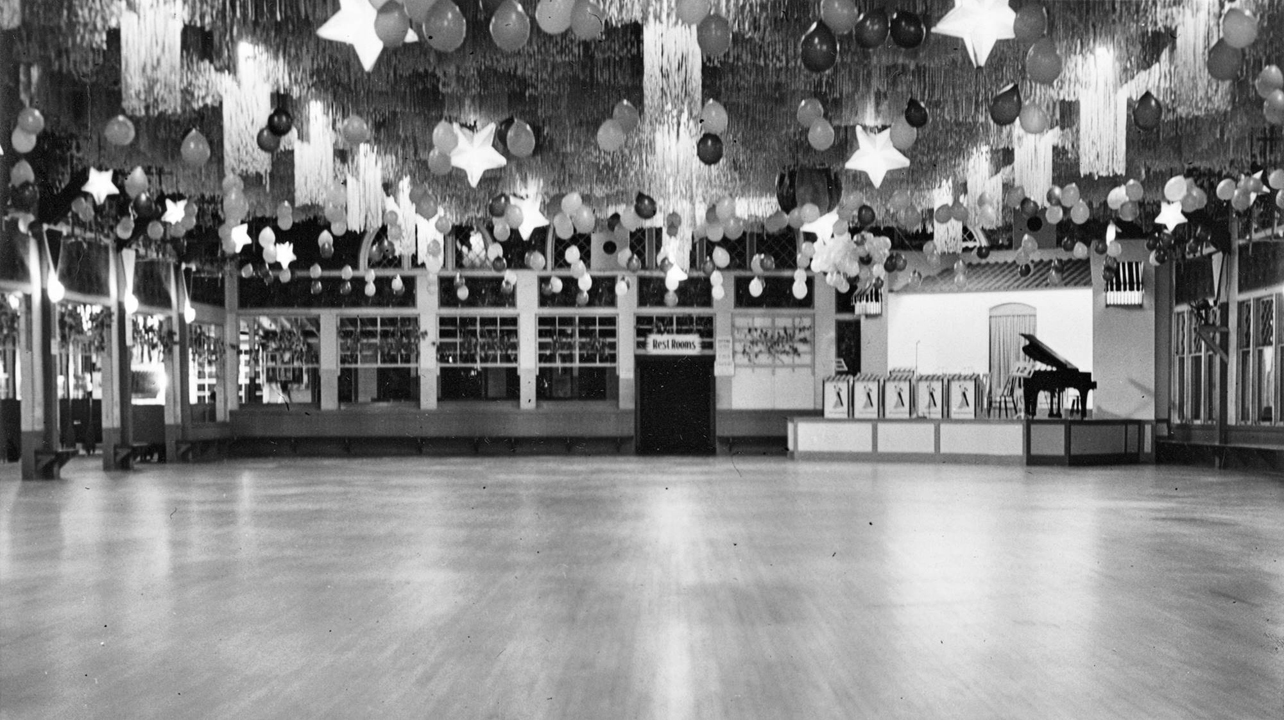
Looking toward the back. Photo courtesy the Excelsior-Lake Minnetonka Historical Society
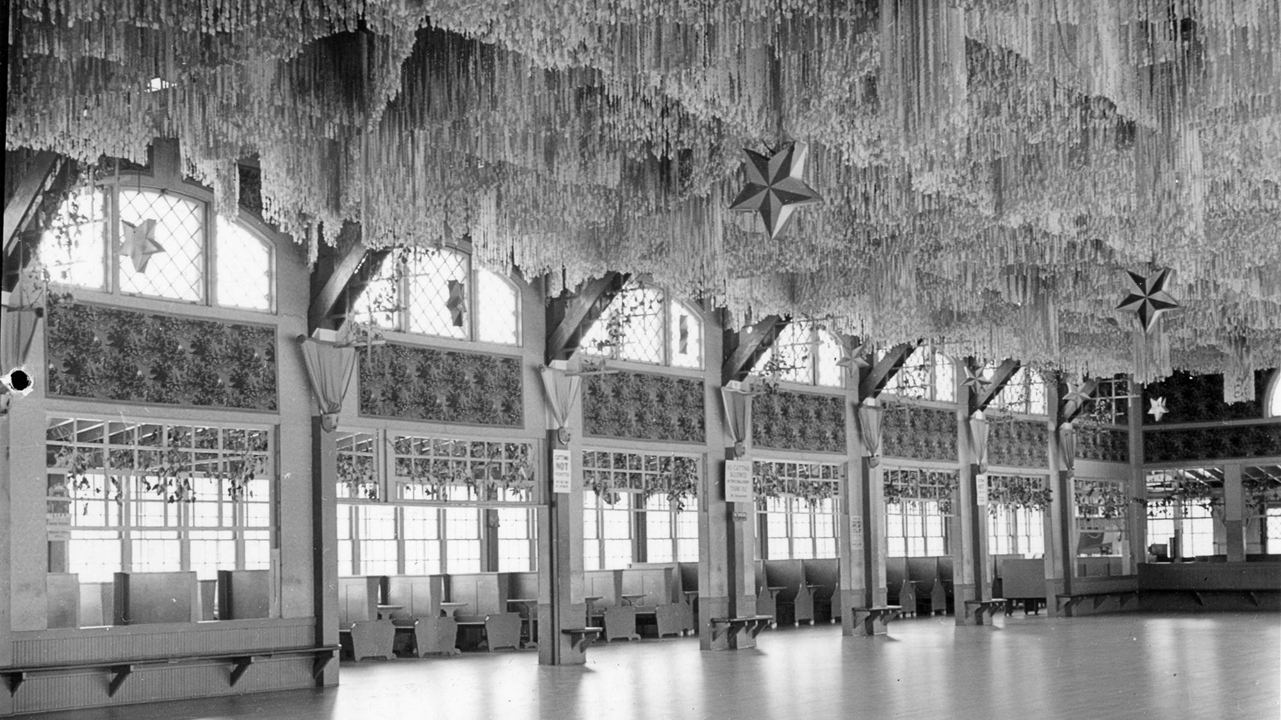
Booths on the east side. Photo courtesy the Excelsior-Lake Minnetonka Historical Society
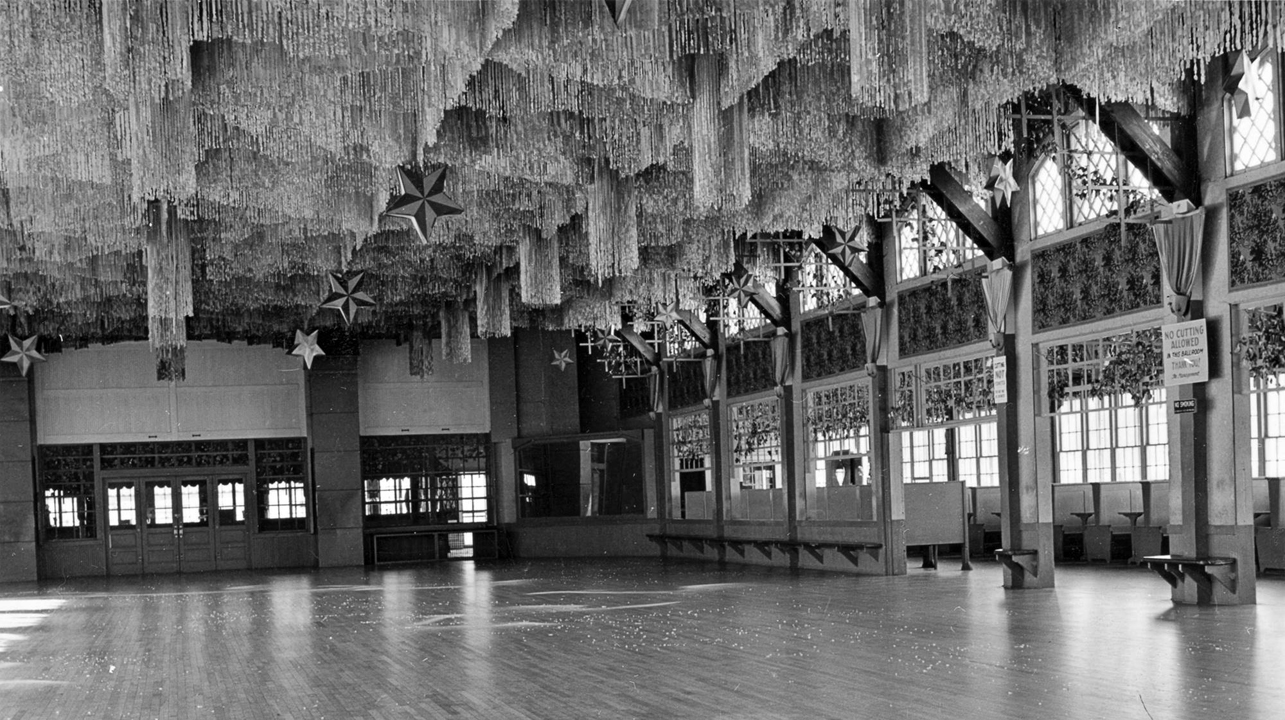
Looking toward the front. Photo courtesy the Excelsior-Lake Minnetonka Historical Society
1943
It’s very possible that there was no Twin City Fun Night in 1943. I found no ads, and the numbering seems to bear this out.
The Ballroom instituted a new policy, operating only five nights a week, dark on Mondays and Tuesdays. Poor weather and young men in the service contributed to low attendance. (Billboard, July 10, 1943)
1944
The Excelsior Amusement Park Pre-Season opening All Twin City High School Night was held on Friday, May 12, 1944. The Ballroom hosted Bud Strawn and his (TC Favorite) Orchestra, featuring Betty Jacobson, soloist.
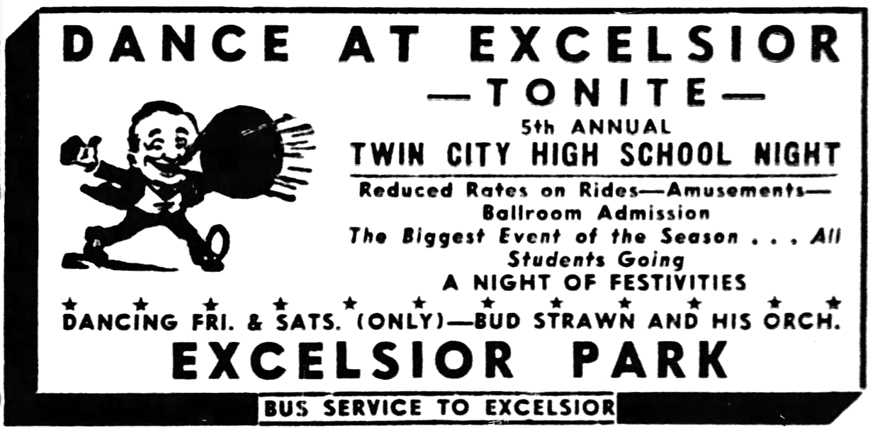
May 12, 1944 – Minneapolis Star
The Ballroom hosted an annual commencement dance on Thursday, June 15, 1944, until 1 am. Bud Strawn’s Orchestra provided the music.
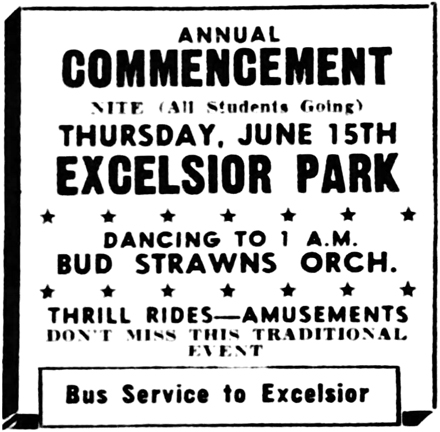
June 14, 1944 – Minneapolis Star
FIGHT!
Poor Rudy Shogran and ballroom employee Clara Munson were arrested for selling beer to a minor as a result of a “rumpus” at the Park on Sunday, June 11, 1944. Here’s the story from the Minneapolis Star:
Deputy Sheriffs Charles Lord and Fred Rosnow went to the park on the report there was a gang fight in progress. They found that a 17-year-old boy, a parolee, had passed out handbills for another dancehall in the ballroom at the park.
At Shogran’s refusal to prosecute, the youth was released.
A crowd of other boys, however, protested to Lord that the youth had been “manhandled.”
One of them, Lord said, who said he was 18, then accused the place of selling beer to minors, and, producing a draft card, allegedly bought a bottle of beer from Mrs. Munson.
Shogran charged that youths attending the dance hall frequently produce faked draft cards to obtain beer.
Charges were dropped against Shogran in justice court after it was shown that he had nothing to do with selling beer. He said that beer was only sold on certain nights when high school youngsters were not there. He also pointed out that underage boys frequently presented fake draft cards in order to buy beer.
Clara Munson plead not guilty and was released without bail Monday. She stood trial before Judge Thomas L. Bergin on June 20, but no report of the outcome was reported in the Strib.
1945
Pre-season openings were held every Friday, Saturday, and Sunday starting on April 20, with Bud Strawn and his Orchestra in the Ballroom on Friday and Saturday nights.
The Annual Twin City High School Night was held on May 11, 1945, where students were invited to jitterbug to Bud Strawn’s Orchestra. In the St. Louis Park Dispatch it was called the Suburban High School Nite.
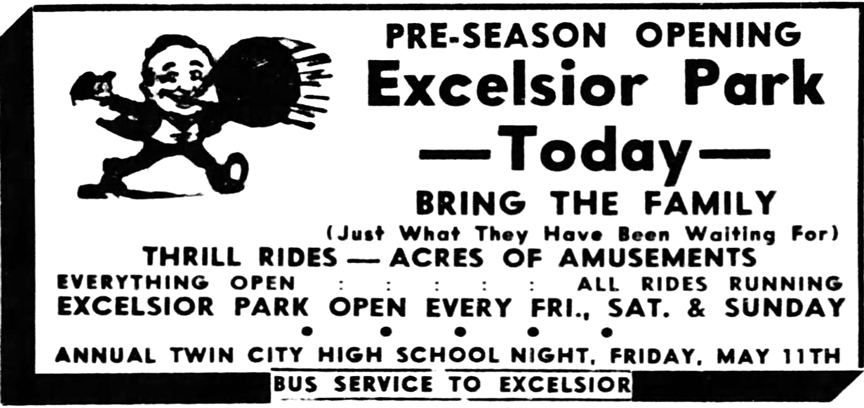
May 6, 1945 – Minneapolis Star
A severe manpower shortage threatened the operation of the Park in 1945, and gas rationing forced the Ballroom to open on Fridays and Saturdays only – Bud Strawn’s Orchestra played the entire year. Good crowds were reported all year.
1946
Twin City High School Nite at Excelsior Amusement Park was May 10, 1946, with music by Bud Strawn and His Orchestra. The Park opened on May 17, 1946.
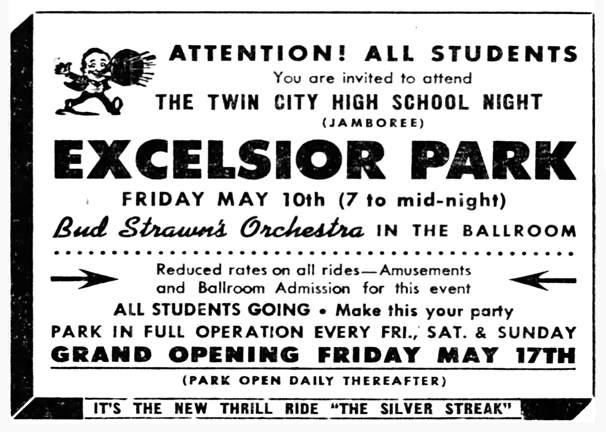
May 9, 1946 – Minneapolis Star
Minnesota had a serious polio outbreak, leading to dramatic drops in attendance at entertainment venues. Billboard reported on August 10, 1946, that an “attendance drop-off was not too noticeable.” But the following week, August 17, Billboard quoted Joe Colihan: “While there is no quarantine on amusements, medical officials have asked children be kept away from crowds on a voluntary basis. As a result our business is way down the last two weeks.”
Curiously, in 1960 Billboard reported that the biggest Labor Day weekend at the Park was in 1946.
1947
Pre-Season openings started on Friday, April 18, with dancing on Fridays and Saturday nights with Bud Strawn and His Orchestra.
Twin City High School Nite at Excelsior Amusement Park was May 9, 1947, with music by Bud Strawn.
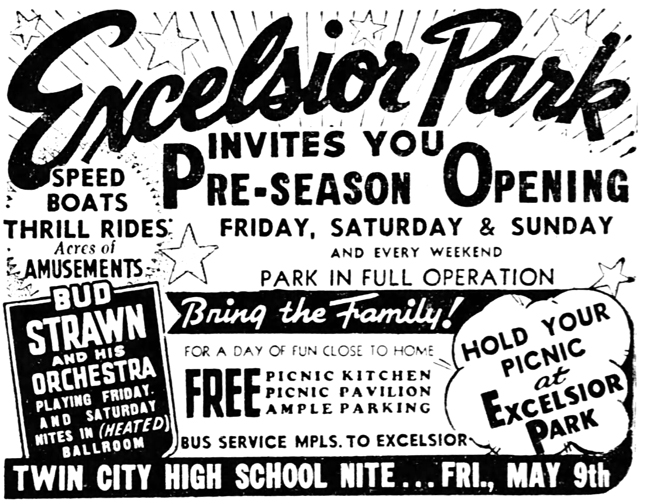
April 13, 1947 – Minneapolis Star
DEATH RIDES COASTER
Such was the headline on August 7, 1947, the day after 21-year-old George Savig plunged 25 feet to his death from the top of the roller coaster at Excelsior Park. He was among a group of three young men and three young women who came to the Park to go dancing. But the Ballroom was closed on this Wednesday, so they went on the roller coaster instead.
George’s seat-mate, Janet Jones of St. Louis Park, described what happened:
We were sitting in the front seat. And I got frightened as we got to the top before that last big dip. I must have leaned forward or screamed or something. I felt his arm around m waist, protecting me. Then the car lurched and he seemed to tumble forward and disappear.
James Hohman, who was sitting behind Savig and Jones, described what he saw:
Just before the dip the car seemed to lurch a little and it appeared as if both George and Janet would go over the front. George seemed to thrust himself forward, as if to pull her back. Then he went over.
Savig, a native of St. Cloud living in Minneapolis, was taken to St. Mary’s hospital, where he died at 10:55 pm. He was pictured on the front page of the Minneapolis Tribune receiving Last Rites from a priest shortly before he died.
His left arm was found the next morning on top of a canopy leading into the Park, 100 feet from the point of impact. His father filed an $11,000 lawsuit against the Park, but the Hennepin County coroner had ruled the death an accident two days after it happened. Park officials said that it was impossible to get out of a seat without standing up. It was the first such accident in 23 years of operation.
If only the Ballroom had been open …
1948
Excelsior Park held its annual Twin City High School Night on April 14, 1948, featuring Bud Strawn and His Orchestra.
Pre-season openings:
- April 24 and 25: Bud Strawn
- April 30, May 1 and 2: Phil Lavant and His Orchestra
- May 7-9: Bud Strawn
- May 14-16: Bud Strawn
The Grand Opening of the Park was on Friday, May 21, 1948. Dancing was offered nightly after the 21st.
Cedric Adams began broadcasting two radio shows, including “Stairway to Stardom” from the picnic pavilion. The pavilion stage was quadrupled in size and a radio control room was installed.
1949
The annual Excelsior Park Pre-Season Suburban High School Dance was held on April 13, 1949, with Bud Strawn’s (new) Orchestra.
Bud Strawn’s 11-piece orchestra played at the Ballroom for its sixth consecutive year.
For the second year, WCCO held Saturday night broadcasts from the Park’s picnic pavilion. Starting with Cedric Adams’s “Stairway to Stardom” show, five half hour shows were broadcast. (Billboard, June 25, 1949) WCCO personalities featured on the show also included Bob DeHaven, Sally Foster, Clellan Card, vocalist Tony Grise, Ramona Gerhard on the Hammond organ, and Wally Olsen’s orchestra.
1950
The Twin City High School Fun Night (now called the Jamboree) was held on May 12, 1950, with Bud Strawn’s Orchestra.
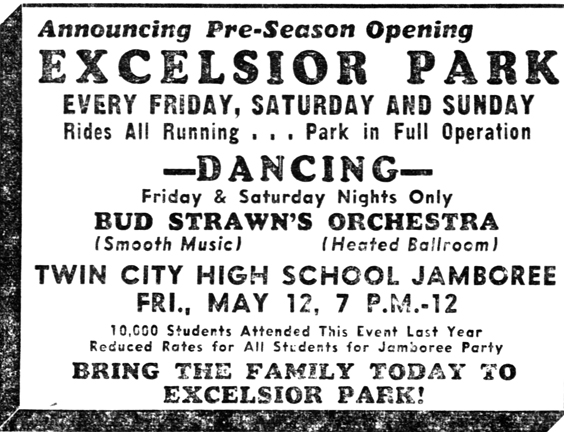
May 7, 1950 – Minneapolis Star
The Park’s attendance was only slightly affected by the scourge of polio, which had shifted its focus from infants to children aged five to nine.
1951
Excelsior Amusement Park had its annual Pre-Season Opening April 20-21, 1951. Dancing (in heated ballroom) Friday and Saturday nights featured Steve Dunning and his Dance Stylists. The April 10 St. Louis Park High Echo included an ad for the event, billed as the Annual Twin City and Suburban High School Jamboree: “10,000 Students attended the Jamboree last year – Don’t miss this annual event – All Students Going”
1952
Excelsior Amusement Park had its Pre-Season Opening starting on April 25, 1952. Dancing (in heated ballroom) Friday and Saturday nights featured Les Williams and His Music From Paradise. This 11-piece band was booked for the season. Loraye Garis was the “ork canary.” (Billboard, May 10, 1952)
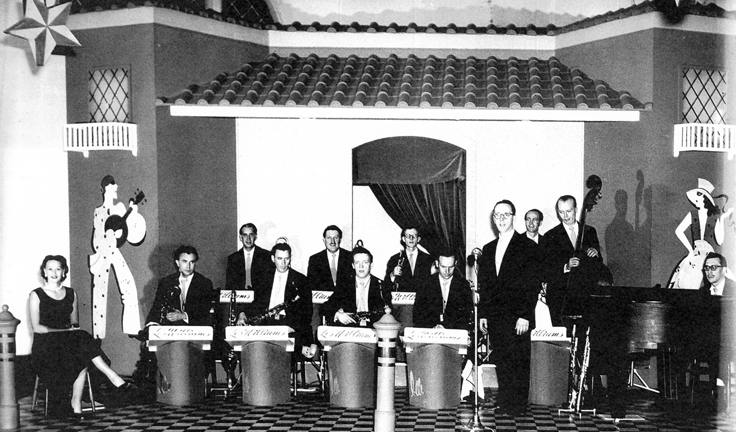
Les Williams Orchestra – Photo courtesy Minnesota Historical Society
The April 22, 1952, St. Louis Park High Echo included an ad for the Annual Twin City and Suburban High School Jamboree, which took place on May 9: “10,000 Students attended the Jamboree last year – Don’t miss this annual event – All Students Going”
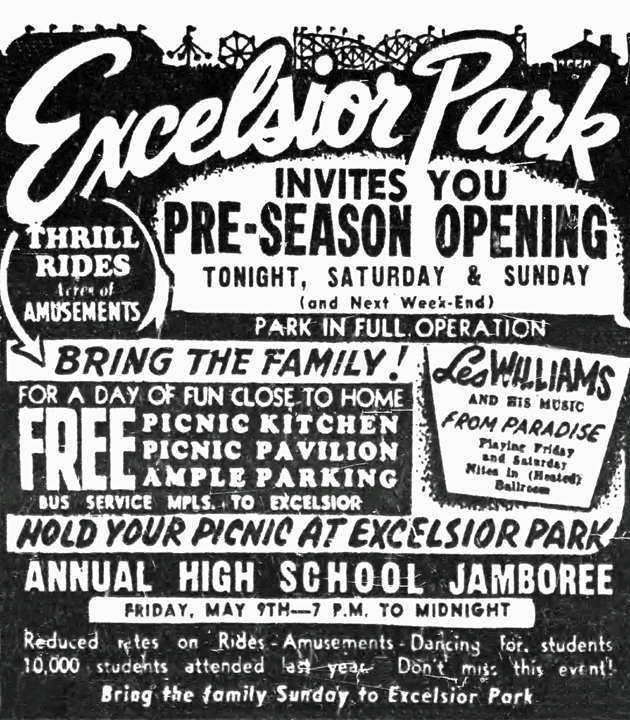
May 2, 1952 – Minneapolis Star
WCCO carried weekly broadcasts from the Park all summer, from the picnic pavilion.
1953
Pre-opening for 1953 was on April 12. The regular opening on Memorial Day drew 10,000 visitors, and July 4’s estimated attendance was 13,000.
The Twin City High School Night took place on May 8, 1953, with Chuck Eddy providing the music. This was described as Shogran’s pet promotion, and this year it drew 14,000 graduating seniors.
For the first time in at least a decade, the Park resumed booking big name orchestras into the Ballroom in 1953. Joe Colihan worked out a deal with the owners of the Prom Ballroom
- May 27: Stan Kenton appeared with his 22 piece band
- July 17: Ralph Flanagan
- July 25: Frankie Carle, his piano and orchestra
- August 7: Jan Garber and his Celebrated Orchestra – “The Idol of Airlanes”
- August 14: Frankie Yankovic, His Accordion and Recording Orchestra
The house band in 1953 was Dick Kast’s 11-piece orchestra.
Bud Strawn, who led the Ballroom orchestra for 15 years, died on December 6, 1953. He had a heart attack and died at the age of 39. Vernon H. Strawn had retired from music to devote full time to his tax accounting work. He was a graduate of Edison High in Minneapolis and the University of Minnesota.
1954
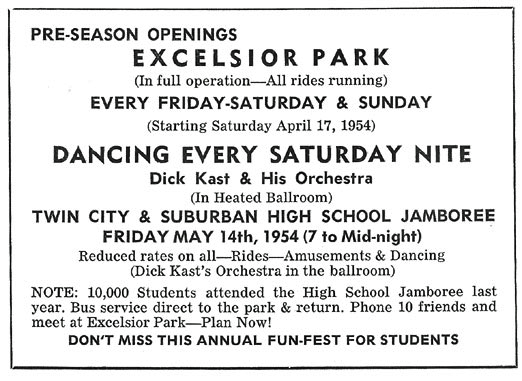
St. Louis Park Echo
The Twin City High School Jamboree took place on May 14, 1954, featuring the very popular Dick Kast and his Orchestra.
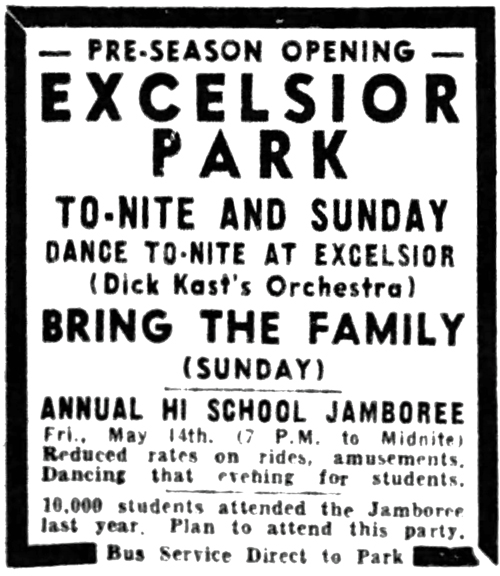
May 1, 1954
In July 1954, Hopalong Cassidy made a two-day visit to the Park. The cover of the July 9 issue of TV Guide was your ticket for two people, and included free ride tickets.
One of many promotional days – sponsored by WMIN-TV, which shared time with WTCN on Channel 11 in those days. Ranger Steve was Steve Cannon, Captain 11 was Jim Lange (later of the Dating Game), and Casey Jones was the most popular guy in town!
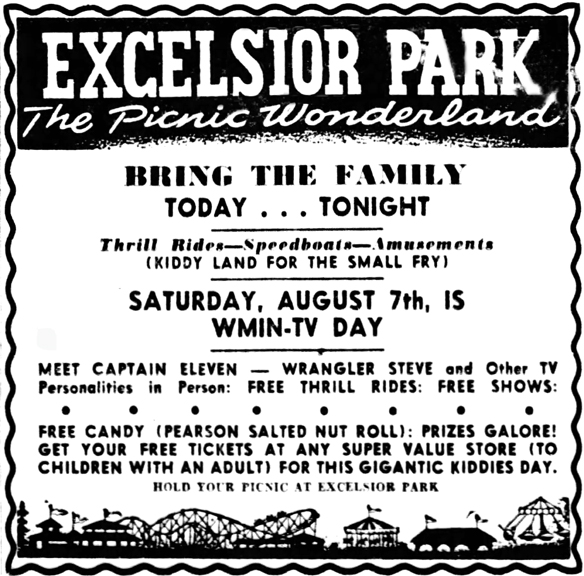
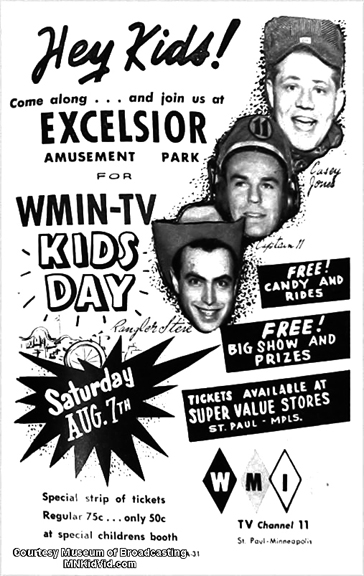
August 7, 1954 – Image courtesy Pavek Museum of Broadcasting
1955
The 15th annual Excelsior Amusement Park Teenage Jamboree was held on May 13, 1955. Entertainment was by Dick Kast’s Orchestra.
Disneyland opened on July 17, 1955, creating a new model for amusement parks around the country.
1956
Excelsior Amusement Park held its annual Teenage Jamboree on May 11, 1956. Entertainment was by Chuck Eddy’s Orchestra.
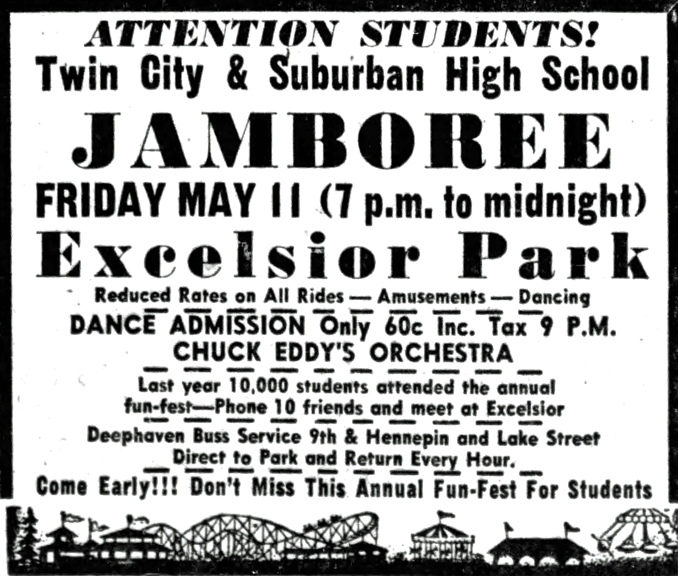
This was the last year that the Ballroom hosted regular dances until it was reopened as Big Reggie’s Danceland in 1961.
1957
Rudy Shogran died on April 8, 1957, of a heart attack. He was 64. Shogran was born in Duluth and had served in World War I. He was a member of the American Legion, and active in the annual mayor’s day activities during the Aquatennial. He had been Director of Public Relations, in charge of promotions at the Park, for almost 28 years. He was also in charge of booking the ballroom. He was survived by hiss wife, Florence, and two sisters, Mrs. Ebba Hess and Mrs. Violet Edwards, both of Canoga Park, California. Al Anderson, a classmate of Ray Colihan, remembers that “Rudy was virtually a chain smoker of some no-name brand that cost 10 cents a pack (vs 15 cents for Camels, etc.).
Ray Colihan was named to take over promotions at the Park, including the Miss Minnesota pageant (see below).
The Excelsior Amusement Park’s 1957 Twin City and Suburban High School Night, held on May 10, featured Dick Davis’s Orchestra.
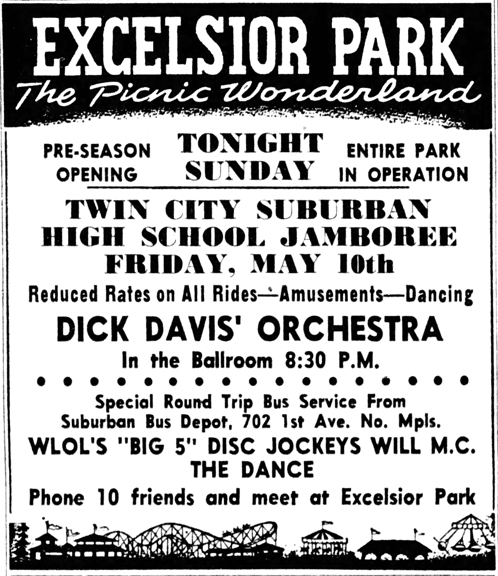
May 4, 1957
Although the music was provided by an orchestra, WLOL was playing early Top 40 at the time. Among the “Big 5” disc jockeys were Leigh Kamman and Steve Cannon.
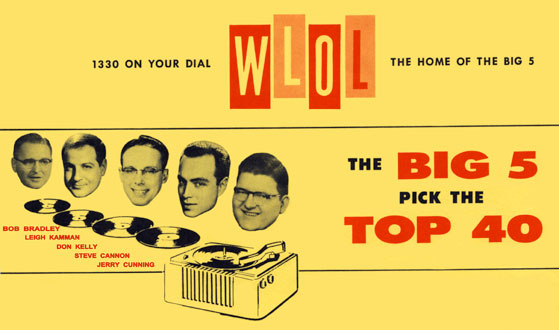
The Ballroom remained dark since 1957 except for occasional rentals.
1958
The Twin City and Suburban High School Jamboree took place on May 9, 1958. Dick Kast’s Orchestra provided the music in the ballroom.
Otherwise, according to Will Jones, the Ballroom was “dark” except for occasional rentals. A Minnetonka Centennial Series article from May 15, 1958, mentions the big bands of the past, but does not include any information about the Ballroom at the time.
One of the special shows held at the ballroom was a Record Hop on August 1, 1958, hosted by WDGY DJ Bill Diehl and WCCO DJ Jim EDDY. The Rock group the Hi-Lites provided live music. This must have been one of the earliest of Diehl’s many such hops that he attended over the years.
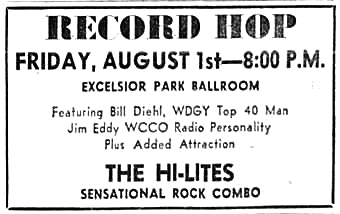
Minneapolis Tribune, July 31, 1958
Ray Colihan booked the Dukes of Dixieland jazz combo for August 18, 1958, and they played to a capacity crowd. The group had just come from a 10-day stint at the Illinois State Fair. The seven-piece group was made up of a father, his two sons, “plus four other Dixie lads.” The group was a smash hit.
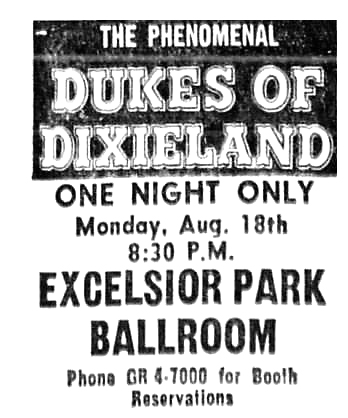
Minneapolis Tribune
The Dukes made a return appearance in the Ballroom on Wednesday, October 22, 1958. This time they were on a break between night club dates in Milwaukee and Chicago. 250 reservations had been made before the formal announcement of the date.
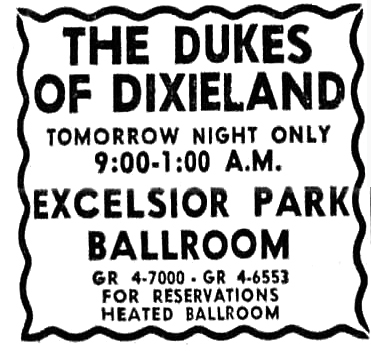
Minneapolis Tribune
In January 1959, Colihan tried to book the Dukes for another appearance for the coming May. However, the group had become very popular nationally, due to appearances on Your Hit Parade and The Timex Jazz Show. As a result their fee had doubled, and Colihan figured he’d have to raise ticket prices from $1.85 to $2.50 just to break even. No evidence that they ever came back.
1959
Excelsior Amusement Park held its 20th annual Twin City & Suburban High School Jamboree on May 8, 1959. “10,000 students attended last year.” They said that every year.
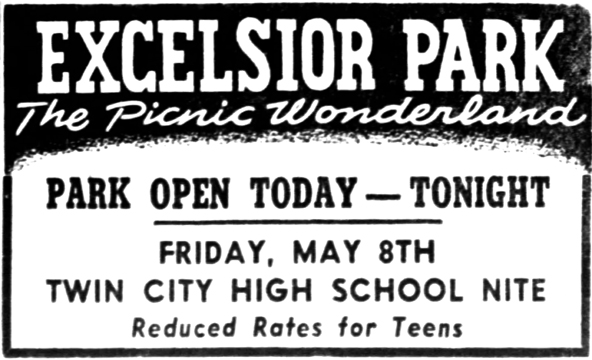
Otherwise, according to Will Jones, the Ballroom was “dark” except for occasional rentals. An item in June 1959 indicated that Colihan was always on the lookout for name acts to bring to the ballroom, but their fees were too high. He usually offered 60 percent of the gate, but acts like Red Nichols and his Five Pennies wanted a guarantee of $1,000, and Louis Armstrong wanted as much as $2,000.
Fred Pearce, Sr. died on August 13, 1959, of a heart attack in suburban Detroit.
In a portent of things to come, in the winter of 1959-1960, the ballroom was used for boat storage by the Excelsior Boat Works.
1960
Ray Colihan became a local personality, as evidence by placement in Will Jones’s “After Last Night” column in the Tribune. Here’s a joke from February 19, 1960. Okay, it’s sexist and may not even be true, but all publicity is good publicity, right?
Ray Colihan, who busies himself summers with running Excelsior Amusement park, busied himself this winter trying to collect a long-standing loan from a crony of his bachelor days. Finally he had an idea. He attached a snapshot of his infant daughter to the note requesting payment and added, “This is why I need the money.” He got back another picture – of a gal in a skimpy bikini – and the playboy’s response: “This is the reason I can’t pay.”
The annual Excelsior Park High School Jamboree took place on May 13, 1960. The ad in the SLP Echo did not name the entertainment.
Otherwise, according to Will Jones, the Ballroom was “dark” except for occasional rentals.
Billboard reported that 1960’s Labor Day was the second largest in the Park’s history, second only to 1946. (Billboard, September 19, 1960)
1961
May 13, 1961: The annual Twin City High School Jamboree took place at Big Reggie’s. National artist (and Twin Cities favorite) Brian Hyland performed at a dance and stage show, and local favorite Mike Waggoner and the Bops provided dance music from 8:30 to 11:30.

May 13, 1961
BIG REGGIE’S DANCELAND
On May 23, 1961, Will Jones tells us that the Ballroom,
dark since 1957 except for occasional rentals, will go into action again this weekend under a new name: Big Reggie’s Danceland. There will be teen-age hops on Fridays and adult-slanted dance sessions on Saturdays. The old lobby is being turned into a piano bar and 3.2 tavern for every-night use, and on Sundays small jazz combos will be featured in that room.” The piano bar was called the “Swingalong Room.
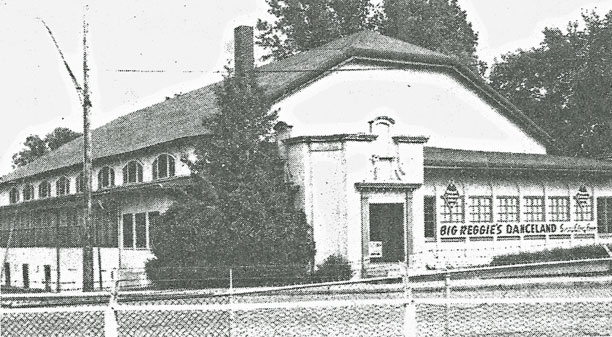
This photo is not so good but it has the Big Reggie’s sign on it.
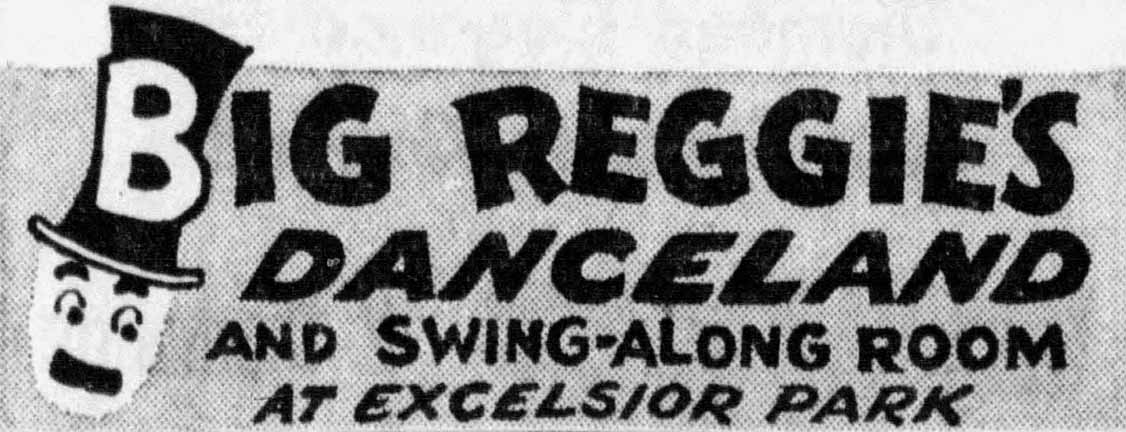
Minneapolis Tribune, Sunday, May 28, 1961
Friday, May 26, 1961: Wayne Turssso and the Velvetones – Teen-agers only!
Saturday, May 27, 1961: Al Noyce Orchestra in the Ballroom; the Les Friedl Combo in the Swingalong Room
Sunday, May 28, 1961: Rusty and Doug (Doug Kershaw) entertained at a Teen Dance in the ballroom. This was also the first weekend appearance of the Dixieland Ramblers in the Swingalong Room. The Dixieland Ramblers, a sextet from Edina, was led by drummer Tom Stevenson. It was stressed that this was no ordinary Dixieland, but a swinging, driving Dixie patterned after the Dukes of Dixieland.
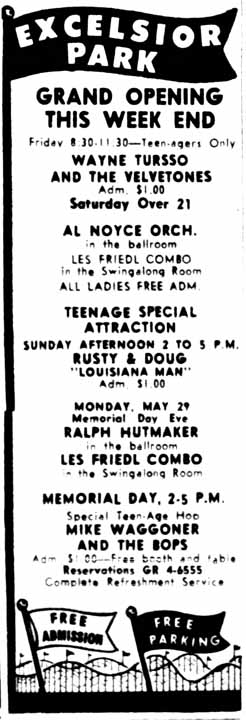
Minneapolis Tribune, May 25, 1961
Monday, May 29, 1961: Ralph Hutmaker in the Ballroom; the Les Friedl Combo in the Swingalong Room. Mike Waggoner and the Bops hosted a teen dance in the afternoon.
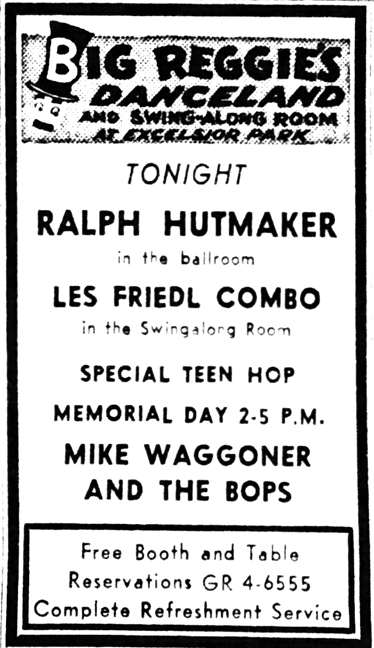
May 29, 1961 – Minneapolis Star
Saturday, June 10, 1961: Al Noyce in the ballroom; Les Friedl in the Swingalong Room
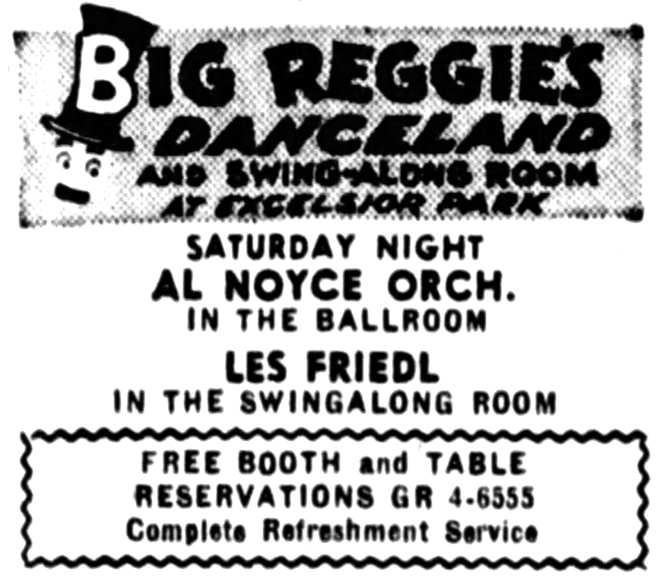
June 9, 1961
Friday, June 16, 1961: Teen Hop with Mike Waggoner and the Bops
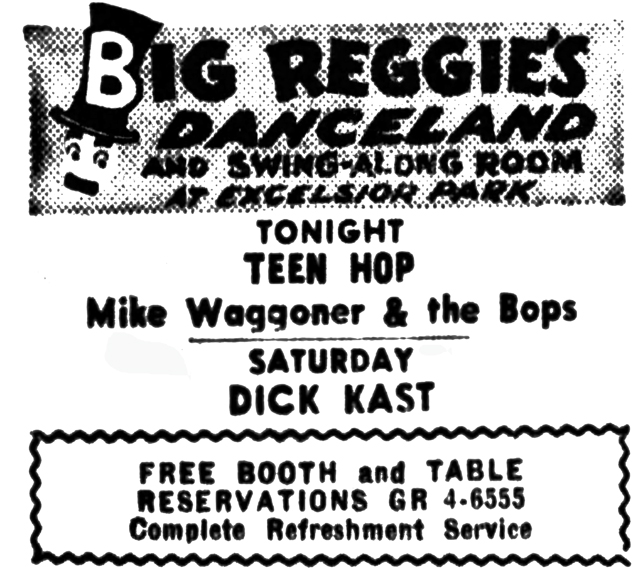
June 16, 1961
Saturday, June 17, 1961: Dick Kast in the ballroom; Les Friedel in the Swingalong Room
Friday, June 23, 1961: Teen Hop with Mike Waggoner and the Bops
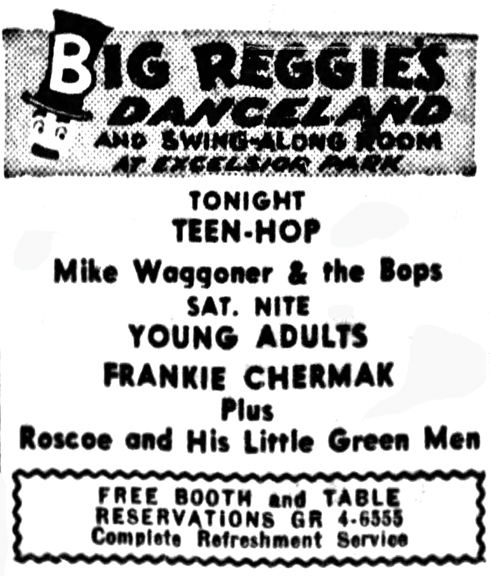
Saturday, June 24, 1961: Frankie Chermak (Dixieland), plus Roscoe and his Little Green Men
Saturday and Sunday, July 15 and 16, 1961: The Dixieland Ramblers. An item dated July 18 says that the Dixieland Ramblers were booked in the Swingalong Room for Saturday and Sunday nights for the rest of the summer.
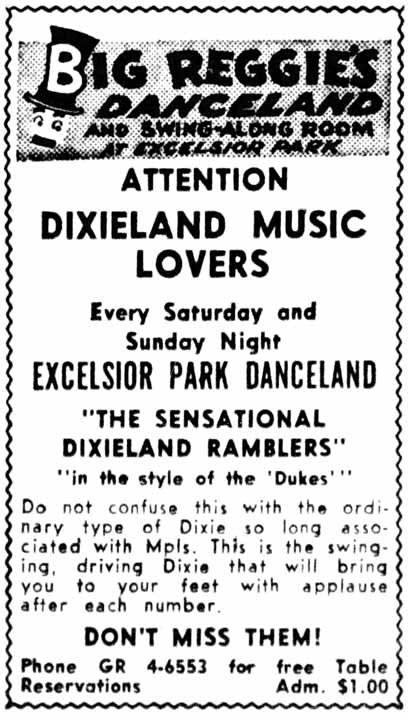
July 19, 1961
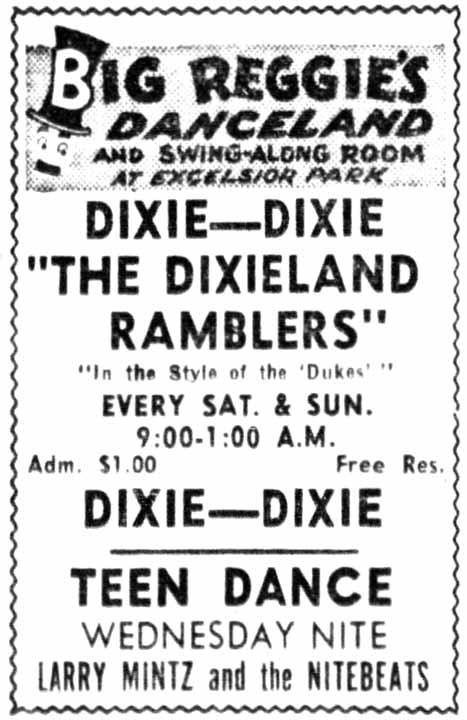
Wednesday, July 19, 1961: Larry Mintz and the Nitebeats in the ballroom.
On August 1, 1961, the law changed regarding “bottle clubs” – places where it was legal for patrons to bring their own alcohol. The law now forbade licensed dance halls to also have bottle club permits. Bottle club permits were ordered returned from a long list of ballrooms in Minnesota, including Danceland.
On August 20, 1961, Roscoe and his Little Green Men made a return to Danceland after a stint at the Torch Club.
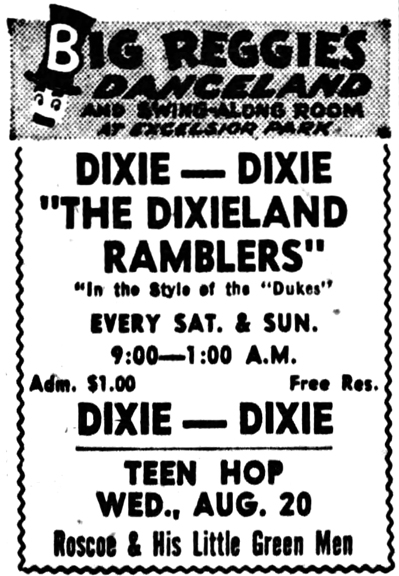
Friday, October 6, 1961: Garry Miles and the Casuals
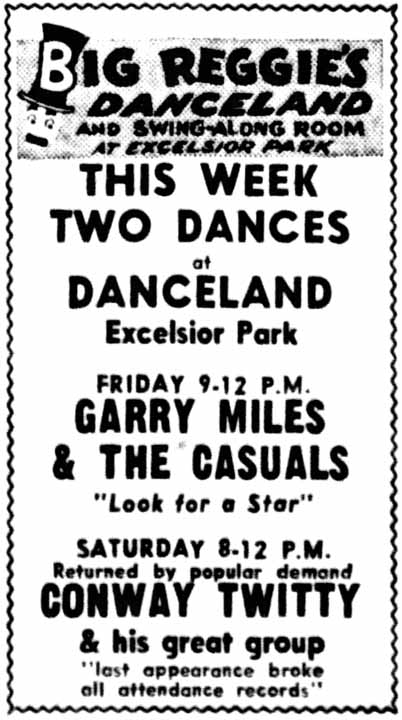
Saturday, October 7, 1961: Conway Twitty. This was Twitty’s second appearance at Danceland in 1961, but so far we can’t find the date of the first one.
Joe Colihan died on October 12, 1961, at age 65.
1962
*Please Note: Despite what you may have read, the Beach Boys were at Danceland in 1963, not 1962. Big Reggie was prescient, but not that prescient.
WDGY High School Fun Day and Night took place on May 12, 1962. This annual event drew an estimated 8,000 high school students from around the area. The fun-filled day featured:
- Dancing from noon to five to Mike Waggoner and the Bops and the Doradoes
- A Twist Contest (you could not escape the Twist in 1962)
- A Saturday night Battle of the Bands, featuring the Ricochets and the Doradoes
- Three WDGY Disk Jockeys tried to break the world’s DJ Roller Coaster Record of 47 rides. DJ Terry Rose took 70 consecutive rides, which took three hours and 21 minutes. During the course of this feat he ate three hot dogs, and lost both his tie clip and seven pounds. “Tired, bruised and exhausted after his 35 mile ride, Rose said ‘I don’t care if I never see another roller coaster.'” (Minneapolis Daily Herald, May 23, 1962)

Teen dances were featured at Danceland every Friday and Saturday night.
May 30, 1962, was Memorial Day and a huge day at Danceland! A show costing a mere $1.85 presented:
- Del Shannon
- Brian Hyland
- The Belmonts
- Jamie Coe (“Cleopatra”)
- Kenny Chandler (“It Might Have Been”)
- The Gigolos (“Bambina”)
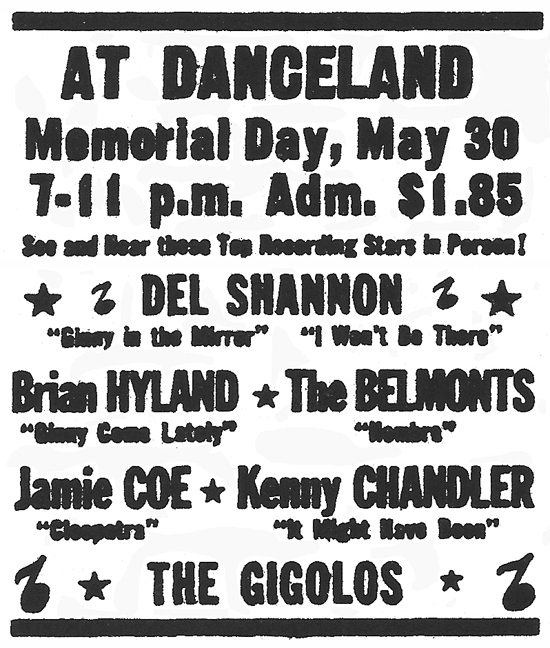
Minneapolis Daily Herald
In June 1962, Excelsior was the scene of a four day “Jazz-Arts Festival” at the Minnetonka Center of Arts. One of the highlights was entertainment by teenagers in the Minnetonka area, including a twist contest won by Pam Witcher and Tom Punch. Doc Evans’ Dixieland band provided the music. The Minneapolis Daily Herald, which was picking up the slack during the Star and Tribune strike, featured kids doing the twist and the mashed potato at Excelsior Park. Barbara Linow (?) sang with Tom Sechrest’s band.
July 4, 1962, entertainment included a “free, outdoor Twistathon. Qualifying rounds will start at 2:30 in the afternoon and the finals will be at 7 pm on the Fourth of July. Cash prizes will be awarded to the winners.” Twist music provided by the Champs (“Tequila,” – which was actually recorded by Glen Campbell). Bill Diehl was the Twistmaster. Okay, it says MC. This event took place at the picnic pavilion and not in Danceland.
Friday, August 10, 1962: The Doradoes
Saturday, August 11, 1962: The Champs
Tuesday, August 14, 1962: Mike Waggoner and the Bops

The next ad found was dated August 17, 1962. Dance dates were:
Friday, August 17, 1962: The Dorados (what’s spelling got to do with it?)
Saturday, August 18, 1962: Roscoe and his Little Green Men
Tuesday, August 21, 1962: The Corvettes

WDGY was back on Sunday, September 9, 1962, for a Back to School Fun Day, words that do not go together. Within the hours of 1 to 3 pm, they promised:
- Battle of the Bands, with the Corvets, Mike Waggoner, and the Doradoes
- Free Rides
- Contests and prizes galore, including Grand Prize Drawing
- The Weegee Wagon, compliments of Brady Olds, St. Paul
- All the Weegee personalities:
- Terry Rose
- T. Thomas Wynn
- Bill Diehl
- Paul Johnson
- Perry St. John

Minneapolis Star, September 6, 1962
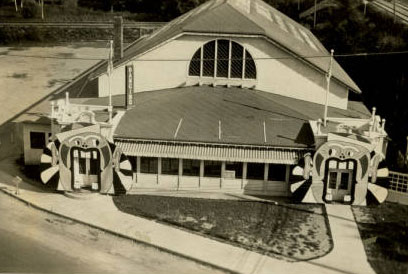
Photo courtesy Excelsior-Lake Minnetonka Historical Society
1963
THE BEACH BOYS AT DANCELAND
Twin City High School Night for 1963 was on Friday, May 3. And it was a doozy!
In February 1963, Colihan booked the Beach Boys to perform for that year’s Twin Cities High School show and dance, reportedly for only $400. At the time they were booked, the group had charted four records on the Billboard charts, notably “Surfin’ Safari,” which entered the chart in August 1962 and reached #14, but they hadn’t had any top 10 hits. Then, on March 23, 1963, “Surfin’ USA” entered the chart, a monster hit eventually reaching #3. So by May 3, 1963, they were BIG, and Colihan had scored a real coup.
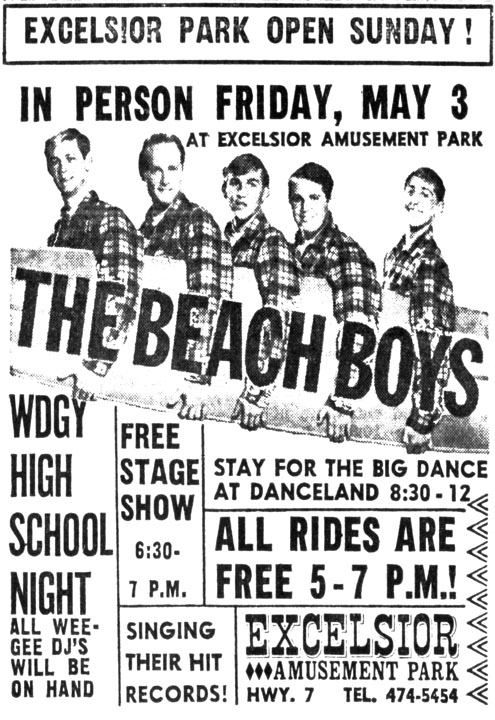
Minneapolis Tribune, Friday, April 26, 1963
The Minnetonka Record predicted:
Thousands and thousands of teenagers from the metropolitan area and suburbs will attend the annual Twin City High School Night at Excelsior Amusement Park and Danceland on Friday, May 3. The special night for high school students will be the twenty-fourth annual event held at Excelsior Amusement Park and there will be free rides, special entertainment, reduced ride rates and dancing during the full evening’s program.
Feature of the evening will be the appearance of the popular top 40 recording stars, The Beach Boys, direct from California. They will headline a free stage show on the outdoor stage of the amusement part from 6:30 to 7 pm Friday. Then they will play for dancing in Danceland starting at 8:30 pm.
The amusement park will throw all rides open free to the high school students between 5 and 7 pm and there will be reduced rates throughout the rest of the evening.
Last year, over 8,000 students from the metropolitan and suburban area attended the annual high school night event at Excelsior Park…
The problem was that thousands and thousands of kids DID show up, jamming Highway 7 for miles around. Colihan was afraid the enthusiastic teens would tear down the roller coaster. As it was they were tearing out the screens and crawling in the windows of Danceland. Police and firemen were called in to control the chaos.
In 1974 Reggie remembered the chaos in an interview in the Insider:
The night the Beach Boys were there, the kids blocked the whole street off. The cops called the fire truck and they were going to turn the hose on them. The kids weren’t doing anything, just standing ’round. They wanted to get as close as they could to the door to hear the music, ya know it was packed inside. So I blocked the street off and let them stand there. One cop wanted to get them off the street so he called the fire chief to come down. I told the chief that the cop wanted to turn the hose on the kids. The chief said, “turn the hose on those kids?” and I was laughing already. I said if you turn the hose on those kids they’ll take their shirts off and will romp ’round and probably turn this fire truck over, and I don’t blame them. With that, the chief said “I ain’t going to have this fire truck turned over,” so he backed it out with the siren blazing and that was the end of it.
In an interview with the Tribune’s Michael Anthony (August 8, 1976), Mike Love remembered:
We cruised into Minneapolis, circling the belt line, I think they call it. I think we went around the city twice before we found the place. We were in a station wagon with a little trailer behind it. Six guys: the band and a road manager
Brian and I walked outside the ballroom after the first set – we did four that night – and people were still coming in. The place was sold out and people were breaking the windows trying to get in. And there was a line of cars going about two miles down the road.
I remember thinking, ‘Gee, this must be what it was like for Elvis Presley.’ We had never seen that many people before.
One local legend is that Al Jardine, the Boys’ bass player, had somehow forgotten his bass, and Colihan played bass, so he rented his instrument to them for the show. Believe it – or not.
The citizenry, of course, was outraged, presenting a petition of 30 names to the Village Council asking it to take strong action to halt large “uncontrolled crowds causing disturbances in the village.” The petition charged that “unprecedented numbers of teen-agers brought to the park by a special dance promotion was clearly out of control of the park and village police.” The Mayor and Village Manager met with Colihan to discuss the matter, and they agreed that the crowd was simply more than the park management had expected.
ROUTE 66 IN MINNEAPOLIS
The cast and crew of the hip show Route 66 came to town in July 1963 to film three episodes in Minneapolis. By this time Tod Stiles’ (Martin Milner) original traveling companion, Buz Murdock (George Maharis) has been replaced by Lincoln Case (Glenn Corbett) because Maharis came down with hepatitis. Will Jones reported that the filming took a crew of 60, plus 15 or 20 wives and a couple of dozen children of crew members who travel with the show during the summer. Filming the three hour-long episodes was expected to take about a month. The whole crew stayed free at the Sheraton-Ritz, which was a prominent locale for the first episode.
On July 25, 1963, the Minnetonka Record reported that the crew had been to Parade Stadium and in Excelsior the week before. On August 1 the Record reported that hundreds of onlookers crowded the Excelsior shoreline last week to watch the cast and crew work at the Amusement Park and the Mark Knowlton home in Excelsior. More scenes were being taken at a Hopkins raspberry farm, it reported.
The episode that was filmed in Excelsior was:
- “And Make Thunder His Tribute,” aired November 1, 1963. Tod and Linc find work with an eccentric farmer. He is at odds with his son about using any new farming ideas and actually uses a shotgun for noise to scare birds away from his crop. The son and he escalate the battle between them over the possible use of the farm as the site of a motel.
A tiny notice in the Minneapolis Tribune tells us that the Everly Brothers came to Danceland on July 21, 1963!
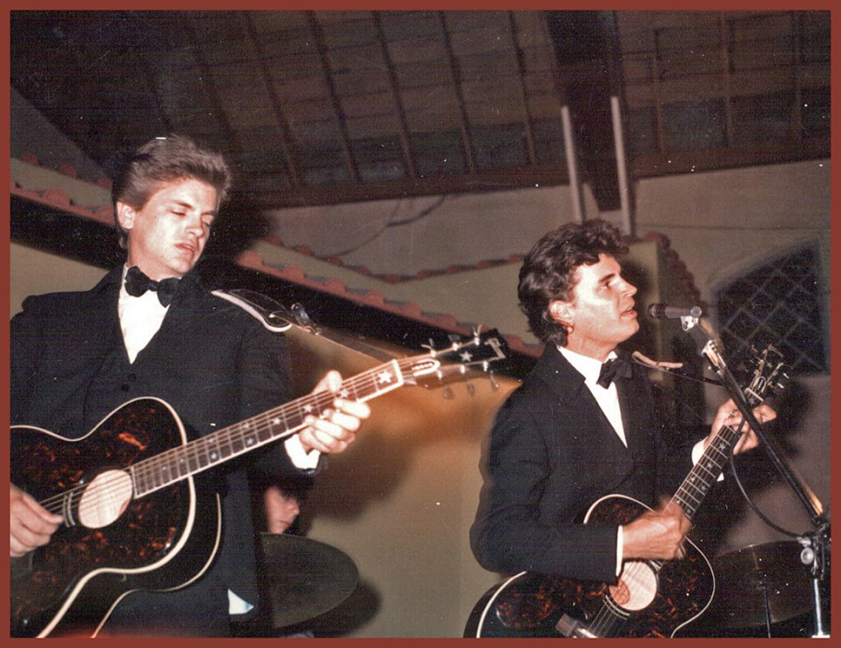
Photo courtesy Rod Eaton
An article in the Star (September 14, 1963), reported that an editorial in the Minnetonka paper charged that Danceland made a “minimum contribution to the community” and was a law enforcement problem. A Rev. Dawes Akers, pastor of Parkers Lake Methodist Church in Plymouth, came to Danceland’s defense, saying that teen-agers need a place to go, and that Danceland was a well-run business with regulations for dress and behavior.
AXEL!
On September 22, 1963, there was more excitement with WCCO Kids’ Day. I wonder if I was there that day! I wasn’t a big Axel viewer (my dad worked for Channel 11 at the time, home of Casey and Roundhouse), but I LOVED all those Hanna-Barbera cartoons! Axel had a big presence at the Park; he was so popular that the Fun House was renamed Axel’s Laff House. Clellan Card, who played Axel, lived in the area.
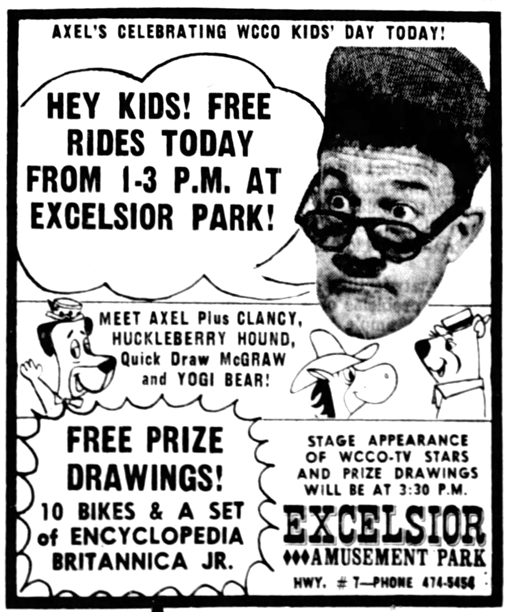
1964
NO BEATLES IN ’64
In April 1964, Big Reggie turned down an opportunity to book the Beatles into the Twin Cities for $20,000 and 60 percent of the gate. He and WDGY Disk Jockey Bill Diehl had gone to the Fab Four’s concert in Chicago that year to check them out.
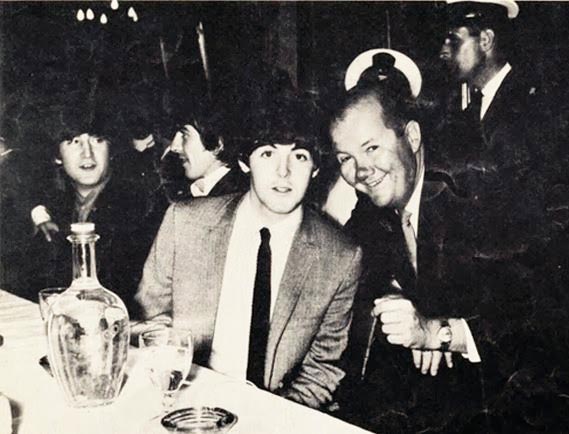
Reggie and the Beatles in Chicago
Reggie decided it was “a bit too chancy, since by August the group’s popularity may have fallen victim to the notoriously fickle tastes of young fans,” reported Don Morrison of the Star (5/28/1964). Reggie mentioned his tough decision to Diehl, who reported it to his WDGY listeners, and Reggie got a pounding. To make up for his blunder, he held a Beatle Day in the Park pavilion on June 7, 1964. Morrison:
Beatle records will be given as prizes and a group called the Female Beatles (a most pedestrian name – I would have chosen “The Beatle-Axes”) will sing in the outdoor pavilion. Also, Colihan hopes to get enough signatures for the world’s longest petition,” supplicating our Britannic friends to make their faces to shine upon us.
Note that this event was held in the Park’s picnic pavilion, not at Danceland.
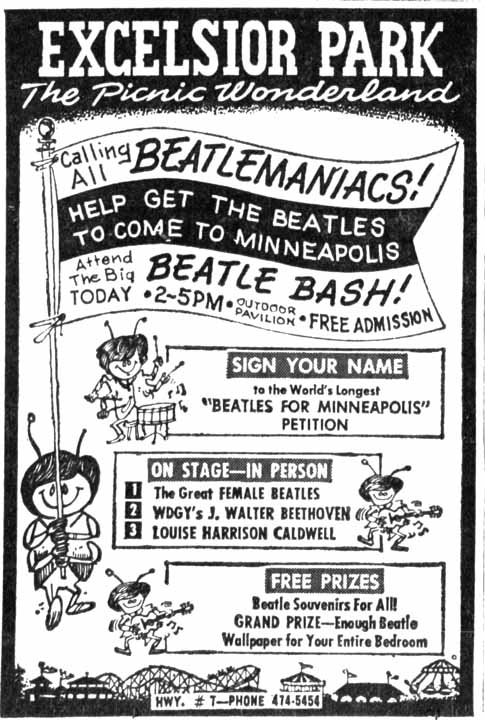
J. Walter Beethoven was a WDGY disk jockey who emceed the event. Louise Harrison Caldwell was George Harrison’s sister. Bill Diehl brought her in to make public appearances. She was not a performer. Would love to hear from the lucky soul who won the Beatle wallpaper!
Another apology was to award two pairs of tickets to see the Beatles at their September 5, 1964, show in Chicago. Hotel and complete transportation were included.
Also see The Beatles in Minnesota
May 8, 1964: WDGY High School Night/ aka School’s Out Spectacular – and spectacular it was, featuring the Trashmen!
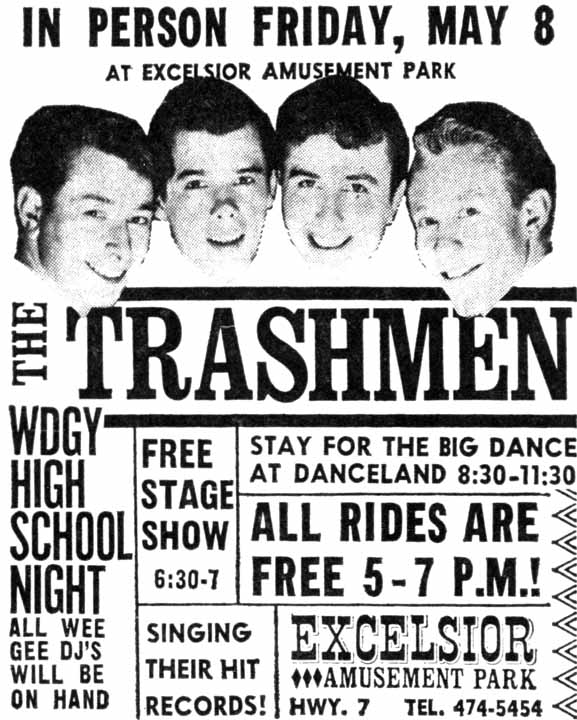
Tony Andreason of the Trashmen said, “When you went to a place like Danceland, there was electricity in the air before the band went on. Once things kicked off, bands would feed off the intensity in the room and [off of] the dancers’ requests.”
STOMPIN’ THE NIGHT (AND THE FLOOR) AWAY
Danceland was a mecca for local “stomp” bands like the Trashmen and the Underbeats. In fact, kids stomped a depression in the dance floor at one Underbeats gig, according to an interview at www.minniepaulmusic.com – the girls screamed, the inspector inspected, and the dance continued.
This is Reggie’s account of the incident, from his September 1974 interview in the Insider:
One night, the manager ran across the street to the park – we had a big night going there as well as having a couple thousand kids in the ballroom – to tell me the floor caved in. He was totally panicked. I used to tell the Underbeats not to play foot-stomping music, cuz the kids would stomp away and the floor was liable to cave in. It was an old building and there was twelve feet between the floor and the ground. So we both went tearing into Danceland and I expected to find a mess, legs and arms broken and kids laying in the basement.
Well, we walked through the crowd to the center of the floor and I didn’t know what to expect. “Where is it?” I asked. We got to the middle of the floor and an are of about thirty feet had dropped four inches. A piling had sunk. The kids were just standing ’round. That’s all there was. A big piling had settled. The cops cleared the kids out while I was in the basement. They had two thousand kids out on the street. I came up from the basement and said “where the hell are the kids?” Not one kid yelled rip-off or wanted their money back. I told the cops to let them back in or we’ll have a riot on our hands. The cops said “well how do we know who paid?” I said “It doesn’t matter. Just let them in.” The band started playing and that was the end of it.
The next day I had to take parents through the place to show them it was safe and that nothing serious happened. Hell, the kids went home and told their parents they danced so hard they caved in the floor. The parents would say “I don’t believe ya,” so I had to give tours the next day to the parents. The kids all remembered it. The night the floor caved in.
Semi-related anecdote: the building had a basement of sorts with a dirt floor. Change from boys’ pockets would come flying out while they were dancing and drop through the floorboards, and after hours certain parties would play poker down there.
THE ROLLING STONES AT DANCELAND
On June 12, 1964, Danceland scored a coup by booking the Rolling Stones, but that didn’t turn out quite so well – see that story HERE.
NATIONAL ACTS
Other than the shows noted above, there were some other national performers who came to Danceland. A search of the Minnetonka Record and the Strib archives yields no ads for these shows, so I can’t give any dates.
Personally verified shows include:
Roy Orbison: Steve Brown can verify that he saw Roy Orbison, probably in 1961 or 1962. Steve and his buddy didn’t dance, but stood at the front to watch the performers. He remembers that he was so impressed that a man with such a small mouth could create such a powerful sound!
Link Wray: Again, Steve remembers seeing this show in the ’61 – ’62 timeframe. Wray’s big hit was a guitar instrumental called “Rumble.”
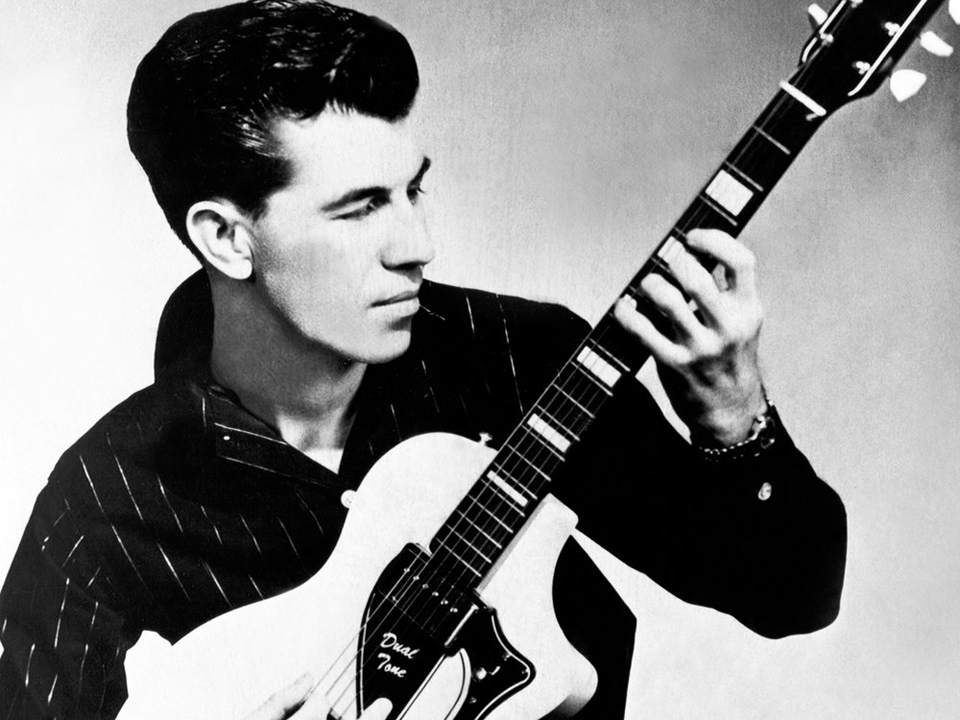
Link Wray (stock photo)
Jerry Lee Lewis: No ads have been found, but several people remember seeing JLL at Danceland – perhaps several times. Trips to the Twin Cities during the 1961 – 1967 Danceland timeframe that we can document are:
April 9, 1962: The Loon (Club soon became Mr. Lucky’s), Minneapolis
January 23, 1963: Prom Ballroom, St. Paul
June 22-28, 1966: Whisky Go Go, St. Paul
Please contact me if you remember any other national acts that graced the bandstand of Danceland!
WHAT WAS DANCELAND LIKE?
Daniel Gabriel provides some details about the fabled dance hall:
Danceland’s door was a thick grey metal affair, soundproofed from the street. Once inside, $1.50 bought a small green ticket and the right to edge past the fat man at the counter into the echoing confines of the hall itself.
The moment of entry was always electric. One felt a surge of energy from the sweating crowd. The wooden floor rumbled ominously beneath the syncopated tread of dancing feet. From the stage at the back of the room, a wave of sound washed over the bobbing heads and crashed against the opposite wall. The outside world was forgotten in an instant.
Fixtures were minimal. A small concession stand near the entrance sold popcorn and candy bars. A row of shabby wooden booths ran along a side wall, serving as illicit drinking cubicles and retirement sites for overheated couples.
We rarely availed ourselves of either. On nights when one of our favorite groups was playing, we’d just stand in front of the stage and watch the band work out. One of the unwritten rules of Twin City teen life in the ’60s was not to applaud the band at a dance. Even the wildest of rave-ups was normally met with an eerie silence. A band gauged its success by the pace of the dancing and the number of silent, staring faces clustered at its feet.
1965
The Park was affected by 1965’s record snowfall, which led to floods. The county drainage system backed up, and about a quarter of the Park was covered by water, just a couple of weeks before the Park was due to open.
On May 22, 1965, there was a “fracas” in Danceland’s parking lot that resulted in the arrest of an 18-year-old. The incident started when a car with three youths entered the parking lot, and deputy sheriff James Parks stopped it. Parks said that they smelled of liquor, although none was found in the car. When he questioned them, they suddenly “clustered around” him in a threatening way. He walked them to the office so he could call their parents, but they ran away. While chasing one of them, Parks tripped, fell, and broke his arm. Somehow one of them was caught and charged with illegal consumption of alcohol by a minor, unlawful escape from custody, and threatening an officer. He was found innocent on a technicality – the judge said that the verdict “didn’t indicate any approval of the boys’ behavior.”
On May 24, 1965, the Excelsior Village Council voted to raise Danceland’s license fee from $150 to $350. The rationale was that the police had been called 24 separate times last year, and the cost of police hours to respond and investigate was about $360. Colihan did not object to the fee raise, but felt he was not getting enough protection for the fee. Danceland employed 11 deputy sheriffs, and Colihan questioned whether extra police were necessary as the Village said they were.
Don’t know if you’ll be able to read this, but here’s a testimonial by Big Reggie about the power of advertising in the Star and Tribune:

September 1, 1965
Danceland came under fire in September of 1965 in an editorial in a local paper that charged it with making a “minimum contribution to the community” and causing a law enforcement problem. The Rev. Dawes Akers, pastor of Parkers Lake Methodist Church in Plymouth came to the Dancehall’s defense, saying that teenagers need a place to go. Then there was this anecdote:
A group of girls was having a meeting the night the tornado struck last May 6. Herding the girls into the basement, [the homeowner] urged them to say a prayer. After a moment’s silence, a quavering voice said, “Dear God, don’t let anything happen to Big Reggie’s Danceland.”
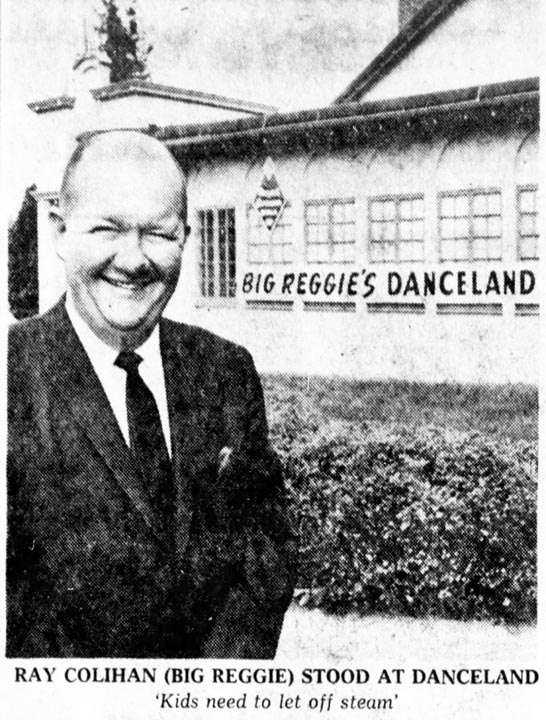
Minneapolis Star, September 14, 1965
1966
THE DANCELAND GANG WAR OF 1966
In the ’60s, Danceland’s popularity led to clashes between kids who had been drinking or were in gangs. The house gang was Excelsior’s X-Boys, who defended their territory against alien gangs like the Suprees, the Baldies and the Animals. Supposedly there were 13 X-Boys, and they wore green and white letterman-like jackets (known as “primas”). Although the dance hall sold no alcohol, it flowed outside, and fights were common.
Fighting was nothing new in Excelsior. In March 1963 the Record reported that a 16-year-old was stabbed in the arm in a street fight.
The fracas apparently started when youths in one parked car on Excelssior’s main street challenged another group driving through town. In the fighting, one youth produced a hunting knife while another was reported wielding a club.
Sam Kanan, owner of the Skipper Cafe, broke up the fighting, grabbed the boys and took them into the cafe and sat them down in a booth and gave first aid to the boy who had been knifed. All this happened just as the Friday night movie let out, so there was “a crowd of about 75 youngsters on hand during the melee.”
JUMP TO 1966
Saturday night, April 16, 1966, was the first dance of the season. Colihan and his head of security had heard rumors that there would be trouble, and had put on extra help to handle it. Excelsior had eight cops in three cars, and the Hennepin County Sheriff’s office had about 20 deputies and officers in the area. About 1,200-1,400 kids were at Danceland that night.
Daniel Gabriel explains that the trouble started because the X-Boys wore approximately the same green primas as the toughest gang in town, the Suprees from Minneapolis. 25 to 30 members of the Suprees came to “take over after previous fights with Lake-area boys.”
One group of 8-10 Suprees was turned away “with a minimum of fuss.” At about 9:30 they returned to inform Excelsior Police Chief Earl Halleck that they had found one of their members in the parking lot across from Danceland, between the telephone company office and Huber Funeral Home. The boy had been beaten with a baseball bat: “The only thing that was holding his nose on his face was some outside skin,” according to Halleck. “The [Suprees] saw the blood on the ground where the boy had been and turned, yelling and shouting threats, to march in a double column toward Danceland.”
“Sheriff’s deputies formed a barrier with squad cars and riot sticks across the street about 200 yards from Danceland and prevented them from entering while deputies and Bush Detectives inside the dance hall kept the crowd inside from going out.”
A variation of the story is told by Gabriel:
When two dozen city-bred street toughs in matching primas came crashing through the door, the dance floor cleared. There were screams, heavy thumps and the leather slap of belt on flesh. The exits jammed up with the swift, the floor upended the clumsy. It was chaos. The actual details of the fight are obscured in legend. Some say a boy died in that fight. Others that he just lost a hand.
Actually, a boy ended up with a slashed neck, coming within a half inch of being killed. He said he had fallen on a beer bottle. It was unclear if he was part of the gang confrontation or not.
The next day the Excelsior Village Council held an emergency session and voted unanimously to suspend Danceland’s license for a period not to exceed 30 days for disturbances in the parking lot, in front of the building, and in other places in the village.
Also that next day, about 30 Suprees came to speak to Halleck, asking for the name of the person who had beat up their fellow member “and indicated they were ‘unhappy’ with the treatment they had received in Excelsior. Halleck told them it was none of their business and sent them on their way. … Some of the group returned on April 20 for further talks, bringing a social worker with them.”
A public hearing at the Excelsior Village Hall was held on April 28. The hearing was requested by James Moran, attorney for the Park. Moran requested that the license be reinstated, arguing “that the brawl was not the fault of Danceland and that the license suspension has caused substantial financial losses to its owner.” The hearing was continued at the Council meeting on May 2, lasting seven hours in all
The license was returned On May 6, with conditions, including:
- At least 10 policemen had to be stationed in and around the premises on dance nights.
- Dancers had to wear “suitable attire.”
- The council tried to work out a dress code, but “got mired in the details of girls’ fashions.” They decided to leave it up to the Village Manager and Colihan to work out the details. The ultimate code required boys to wear shirts with collars and to tuck them into their slacks. Boys had to wear leather shoes, not tennis shoes or sandals. Girls could wear Bermudas but nothing shorter. No bare midriffs and no “T-shirt-type fashions.”
- More lighting had to be installed in the parking lots.
- Patrons who left the hall had to pay an extra admission to go back in.
- The cigarette machine had to be removed.
- In compliance with a 1919 law, anyone under 18 had to have permission from their parents. Although Colihan said that this law was largely ignored in the dancehall business, he agreed to the condition.
- Colihan had to make a report to the Council after a dance on the number of liquor violations there were and the disposition of each.
- Danceland had to pay the cost of extra police on riot nights.
In an interesting note, the gang member who got beat up with the baseball bat sued the Village of Excelsior for $100,000 for negligence in keeping the peace! The article didn’t give the name of the kid. Another article reported that Barry Reoh, 17, of Edina was treated at General Hospital for cuts and bruises received in the fight, but he might have been the one slashed with the beer bottle.
For some reason (maybe because of the trouble with gangs), I found no ads for Danceland in the Minnetonka Record in 1966. Given the trouble that spring, perhaps Reggie tried booking more “tame” types of entertainment – for instance, this dog show!
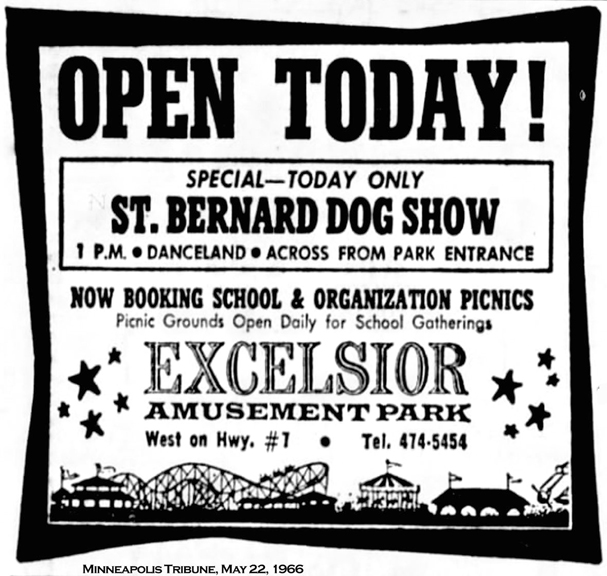
And perhaps turning away from Rock ‘n’ Roll was on the horizon (although this probably wasn’t in the Ballroom):
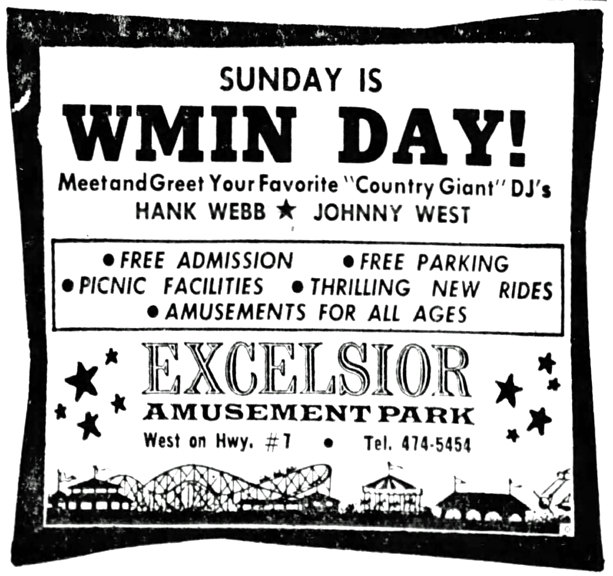
Minneapolis Star, August 19, 1966
1967
Excelsior’s Village Council met on April 17 and issued Colihan his dancehall license for $350. Colihan was asked whether he kept a list of “troublemakers so that they could be watched in the future. Colihan replied that such a record was kept but the troublemakers will be barred after ‘one time only.'” Halleck reported that there had been no trouble after the reinstatement of the license last year. The Mayor said that he had heard that the Suprees had “dissolved.” One source said that the Suprees had all been drafted.
The first dance of the season at Danceland was on April 28, 1967. Park owner Fred Pearce made it clear that Colihan, who leased it from the Park, was wholly responsible for what went on.
Dances were planned for Fridays and Saturdays until school was out and then Tuesdays would be added.
Correspondent Rollie Anderson shares this account from July 28, 1967 – probably one of the last dances at the fabled Danceland:
This evening Jerry, Marilyn and I went over to Shari’s to pick her up to go to Excelsior Park to see the Hot Half Dozen [The band advertised as the Hot Half Dozen but officially, their name was simply the Half Dozen.] Jerry knows a guy in that group who lived in Holdingford and graduated with his sister, Janet – Daryl Litchy. When we four got to Danceland, I paid $6.00 for all of us because I didn’t want to make Jerry think that he had to pay for my sister, Marilyn. It was sort of an embarrassment when inside because there were so few there and no one was dancing. But during the night, things picked up a lot. As I figured, the Hot Half Dozen played “Heat Wave” just as good as ever. I always liked their recording of that song and little did I know when I heard it on the radio last year that the lead singer was from Holdingford. Jerry talked to him during one of their breaks and he remembered Jerry’s name, but didn’t have much to say. [According to Soma records, James Walsh was the lead singer, at least on the recording of “Heatwave.”]
Danceland closed on August 29, 1967, for the season.
1968
DANCELAND CLOSES
By 1968 Big Reggie no longer had the lease for the property. Fred Pearce, the owner of the building, had leased it to Robert Mecay and Thomas Costaneda in early 1968, but when they applied for a set-up license to operate an adult operation with liquor they were flatly refused by the Village Council. They wanted to come back with a request to run a teen club (Mecay had five years’ experience), but on May 13, 1968, owner Fred Pearce announced that he was losing money on the dance hall and had decided to rent it out as a storage building for boats and snowmobiles.
1973
DANCELAND BURNING
Danceland burned to the ground in a fire that started at 2 am on July 8, 1973. The Excelsior and Minnetonka Fire Departments responded, with the Mound FD manning the Excelsior station. Chief Labahn Morse said the building was “totally involved” in flames when they arrived and with a building that size, no amount of water could have had much effect on the fire. Water was pumped from Lake Minnetonka, but the fire hoses kept filling up with algae and had to be constantly cleared out. The overpass over Highway 7 to Excelsior had to be closed because of sparks and heat. Flames could be seen for miles.
The fire smoldered for two days and damage (including 38 boats and 47 snowmobiles) came to $136,200 One firefighter was injured fighting the blaze when debris fell on him and he was rushed to Methodist Hospital. Ironically, the building was scheduled to be razed that fall and possibly used as a controlled burning exercise for the Excelsior Volunteer Fire Department.
ARSON SUSPECTED
Chief Morse reported that the fire appeared to have been started at 8 to 10 different spots and that gasoline was used, leading to a swift, all-encompassing blaze.
An account of the fire was written by Julia Plant in her book about her brother, Mike Plant, entitled Coyote Lost at Sea. According to Julia, they came from a wealthy family, but probably due to a traumatic brain injury caused by concussions, Mike had become “an angry adolescent who kicked cops in the head, smuggled and sold drugs, and did everything possible to show everyone he was nothing like his polite, soft-spoken, intelligent father.” She found out after the fact that it was Mike who suggested to his old friend, Jeffrey Malloy Williams, that they burn down Danceland. The community figured it was slated for demolition anyway, and a bunch of drunk kids figured they’d accelerate the process.
Julia:
That evening word spread quickly that something was going to happen at Danceland around midnight. At least thirty kids showed up. … We all turned and ran off like a pack of dogs, stopping a couple of blocks away to hide on the hill in the park and watch the huge wooden building burst into flames. But it didn’t just burst into flames – it exploded into a visual splendor of bright orange against the black night sky. It was an incredible sight. Only later did we find out there were at least one hundred snowmobiles stored inside with gas in their tanks.
Jeff went to a local gas station to fill a one-gallon container of gas. At the hall’s entrance, Jeff poured the gas “and Mike lit the match.” As it turned out, a couple of out-of-town girls staying in an apartment nearby had seen Jeff, “wasted and boisterous, wearing a red bandana around his head.” Against Mike’s advice, Jeff didn’t remove the bandana in the police lineup and was easily identified. Another witness had seen Jeff at the gas station.
The insurance company was not going to pay for the damage unless someone was found culpable for the arson, and the law came down on Jeff, then 23 years old.
The complaint filed against Williams alleges that, “aided and abetted” by other persons, he set fire to Danceland. It alleges further that there was a gathering of “kids” prior to the fire, that Williams was observed near the building with an empty gasoline can in his hand, and that he said the building was going to be burned down.
Jeff spent three years in prison – Jeff never implicated Mike, and Mike never admitted his role.
Did Mike Plant light the match? Alas, Mike was lost at sea on his sailboat Coyote.
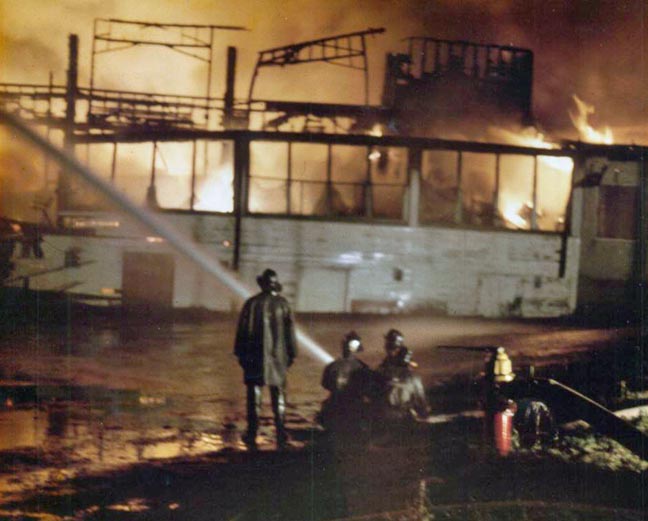
Photos above and below from the Excelsior Fire District Facebook Page
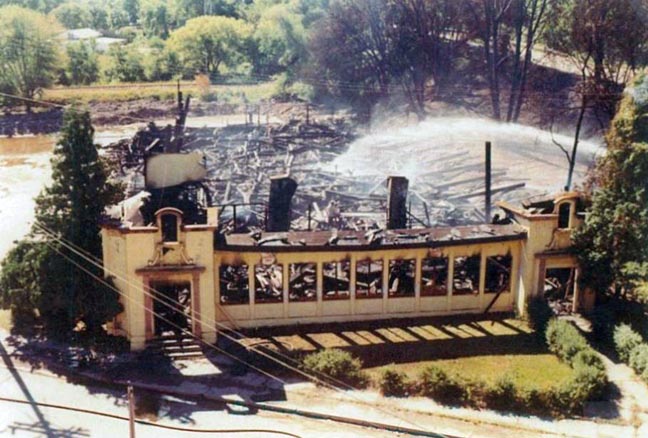
VALLEYFAIR
Excelsior Park, still in the Pearce family, closed on September 16, 1973, with little fanfare. With the advent of amusement parks like Six Flags, it was determined that the relatively small Excelsior Park had to expand, but there was no more room. Although the Park was still profitable, it was aging and becoming old fashioned. A new site on 235 acres on the Minnesota River in Shakopee was found and dubbed Valleyfair. The Pearce family were co-owners of the new amusement park.
Demolition of Excelsior Park started in May 1974, and an auction was held on July 24, 1974. The roller coaster was demolished, and the carousel building was given away and later demolished. The carousel horses were moved to Valleyfair.
The Danceland site (685 Excelsior Blvd.) is now occupied by an office building and parking lot.
There is much more on Danceland on Lake Minnetonka.Com
MISS MINNESOTA/AMERICA
For several years, in his role as Park promotions director, Rudy Shogran produced the Miss Minnesota pageant. This special event usually took place at the picnic pavilion, but there is some evidence that the contest was located in the Ballroom at least one year. The pavilion had a roof but no walls, so maybe it was too cold for those poor girls in swimsuits.
1938
In August 1938, Cedric Adams was the judge of the Miss Minnetonka pageant at the Park. The winner went on to the Miss Minnesota contest at Lynwood Park in Lynd, Minnesota. The winner of that contest, Avis Darrow of Duluth, went on to the Miss America contest in Atlantic City. Other judges were the Mayors of Excelsior, Mound, Island Park, and Wayzata.
1941
The Park hosted the Miss Minnesota contest on August 17, 1941. The bathing suit elimination contest was held at 4 pm, and the contestants demonstrated their talents while in evening gowns at 8 pm. Glad Olinger and his band provided the music. Patricia Tiets competed as Miss Minnesota at the Miss America Pageant.
1942
The Park hosted the Miss Minnesota contest on August 10, 1942. Jane Groerner of Minneapolis competed as Miss Minnesota at the Miss America Pageant.
1943
In 1943 the Park was officially granted the official franchise for the Miss Minnesota contest. (Billboard, July 10, 1943) On August 22, 1943, Florence Hunton from Minneapolis won the contest.
1944
On August 13, 1944, Patricia Cummings won the Miss Minnesota contest and placed in the Top 12 in the Miss America contest.
1945
On August 12, 1945, 75 women competed for the title of Miss Minnesota. Winner Arlene Anderson, competing as Miss Minneapolis, placed as fourth runner-up at the Miss America pageant.
1946
On August 11, 1946, Miss St. Paul Rosemarie Gregg won the Miss Minnesota contest. There were 47 entrants that year.
Below is not the winning Miss Gregg, but Miss Dorothy Mallory of Hopkins, another 1946 candidate of note.
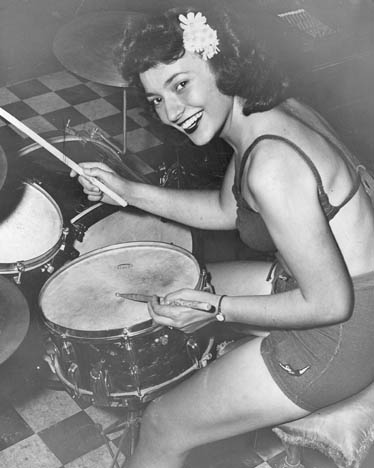
1947
Elaine Campbell, competing as Miss Minneapolis, was named Miss Minnesota on August 17, 1947, out of a field of 22 candidates. Miss Campbell was a 1942 graduate of St. Louis Park Park High School and had attended the U of M for two years. At the Miss America contest she sang opera despite a throat infection. She was first runner-up and went away with a $3,000 scholarship and a $450 wardrobe.
1948
BeBe SHOPP
Beatrice Bella Shopp, better known as BeBe Shopp, became Miss Minnesota at the Park on August 22, 1948, competing as Miss Hopkins. She had competed the year before, just for the experience, since she was ineligible at age 17. Once she won Miss Minnesota, she was groomed by Rudy Shogran:
She told of the endless hours of training which Shogran furnished after she became Miss Minnesota to help her win the top title. There were speech classes, modeling hints, make-up lessons, and constant practice on the vibraharp which were necessary to take her to victory. (Billboard, October 9, 1948)
BeBe went on to become Miss America in September. On September 15, 1948, the Park was opened for a parade for BeBe, who played her winning vibraharp selections for the crowd, estimated at 5,000. Jean Sheils, Miss Edina, took BeBe’s place as Miss Minnesota.
On July 2, 1949, the Park held a special event for BeBe as she started her tour of Europe. (Billboard, June 25, 1949)
1949
The 1949 Miss Minnesota contest was scheduled for August 21. Gloria Burkhart, competing as Miss Minneapolis, became Miss Minnesota at the Park’s competition. She placed in the Top 15 at the Miss America pageant. This was the first time the Miss Minnesota contest was televised, on pioneering TV station KSTP.
1950
The tenth annual Miss Minnesota contest was held at the Park on August 13, 1950. Cedric Adams of WCCO was the emcee of the bathing suit competition, and Jack Thayer of WLOL was the emcee of the evening gown and talent competitions. Music was provided by Bud Strawn’s Orchestra, the Park’s house band. Jeanne Traun, competing as Miss Minneapolis, was crowned Miss Minnesota. Excitement ensued when a skunk infiltrated the pavilion during preliminaries on August 10.
1951
SMORGY ENTERS LULU
In 1951 the Tribune had its own home-grown comic strip called “Smorgy,” drawn by Kurt Carlson and featuring a large-nosed Scandinavian fellow with a girlfriend named Lulu Fisk. Smorgy decided to sponsor Lulu as a contestant in the Miss Minnesota contest.

August 6, 1951

August 7, 1951

August 8, 1951

August 9, 1951

August 11, 1951
Despite the machinations of Smorgy, on August 12, 1951, Katherine Clark, competing as Miss Minneapolis, won the title of Miss Minnesota.
1952
Smorgy once again tried to horn in on the Miss Minnesota contest:

August 4, 1952

August 5, 1952

August 6, 1952
On August 10, 1952, Excelsior Park hosted the 12th annual Miss Minnesota Pageant. Cedric Adams of WCCO radio was the emcee of the bathing suit competition, and Jack Thayer of WLOL emceed the evening gown and talent competitions. Music was provided by Les Williams and His Orchestra. A highlight of this year’s contest was the participation of fraternal twins Eileen and Irene Wencl. They were both 18-year-old sophomores at the University of Minnesota. They were from Owatonna, but unclear what their individual titles were. Carole Wick, competing as Miss Duluth, was crowned Miss Minnesota.
1953
On August 9, 1953, Idell Hulin was the winner of the Miss Minnesota contest, over 23 other contestants. The was the 13th Miss Minnesota to compete in the Miss America pageant.
1954
MISS MINNESOTA/USA
1954 was the year that the Park lost the franchise for the Miss Minnesota/America franchise. Cedric Adams explained that the State Jaycees took over the event and wanted more competitive contestants, preferably college girls. The 1954 contest went to Austin, Minnesota. The Park had to do with an appearance by Hopalong Cassidy.
1956
July 1, 1956, saw the return of the Miss Minnesota contest, but with a twist – this Miss Minnesota would go on to the Miss USA contest, and the winner of that pageant would go on to vie for Miss Universe. The Miss Universe pageant was founded in 1952 by Pacific Knitting Mills, manufacturer of the mandatory Catalina Swimwear. The company had sponsored the Miss America pageant until 1951, when the winner refused to pose for publicity pictures wearing one of their swimsuits. In 1956, 18 judges unanimously chose Marilyn Johnson on the first ballot as their Miss Minnesota. She went on to the Miss USA pageant in Long Beach on July 12.
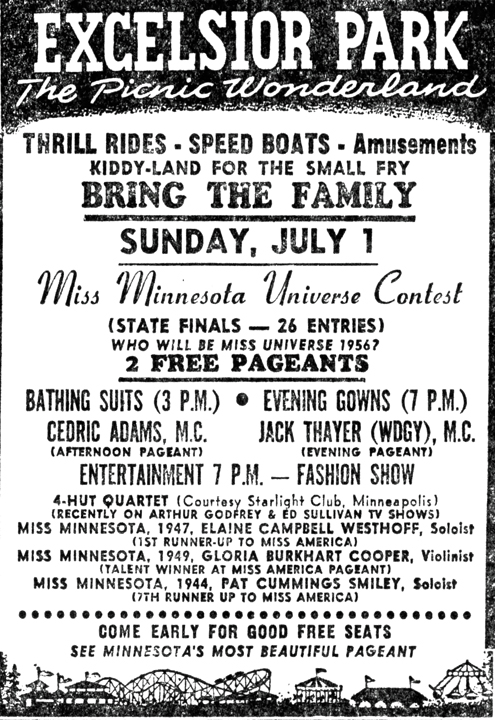
1956
1957
Upon the death of Rudy Shogran on April 8, 1957, Ray Colihan was named his successor as the Park’s public relations director. One of his new duties was to produce the Miss Minnesota-Universe Pageant, which took place on June 16, 1957. Jack Thayer of WDGY was the emcee and music was provided by singer Gloria Greer, the Joe Kimble Trio, and the Showoffs. Mary M. Ford won the honors out of a field of 21 contestants, going on to Long Beach on July 11.
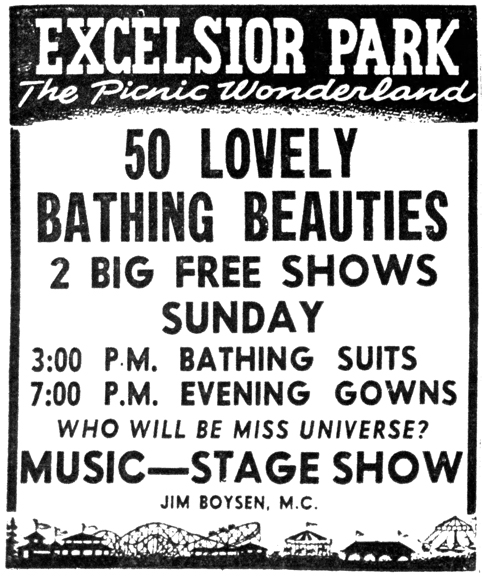
June 8, 1957
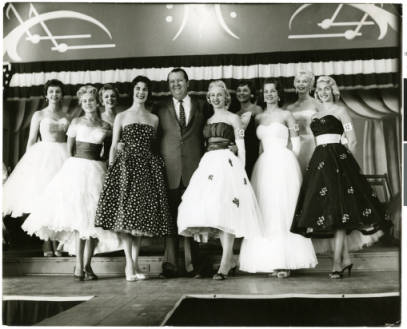
Photo courtesy Excelsior-Lake Minnetonka Historical Society
1958
In 1958 the contestants from Minneapolis and St. Paul competed on June 8. The top eight winners then competed with 20 contestants from outstate Minnesota on June 15. The winner, Miss Minnesota USA, was Sue Bouchard from Minneapolis. The Park paid for Sue’s wardrobe, expenses, and transportation to the Miss USA pageant on July 23 in Long Beach. Unfortunately Sue did not make the top 15.
1959
The 1959 Twin Cities preliminaries of the Miss Minnesota-USA contest were held at the Park on June 14, with the finals on June 21. Muriel Fairbanks was the winner.
1960
The Park did not host a beauty contest in 1960 and presumably anytime afterwards. Instead, celebrities were brought in as a special event for Cerebral Palsy Benefit Days:
- Boxer Jack Dempsey came to sign autographs on August 11,
- Marvin Miller, star of the TV show “The Millionaire,” came to give away million dollar checks on August 12, and
- Lt. Rip Masters, star of the Rin Tin Tin TV series did two performances on April 13. Doesn’t actually say whether he brought the dog with him.
JOE COLIHAN
Joe was born on September 6, 1896, in Danbury, Connecticut. Following in the footsteps of his father John, Joe spent his life in the amusement industry, operating rides at fairs, carnival, and amusement parks. Some of these jobs included:
- Ride man with the Johnny J. Jones Exposition in 1902
- Traver Engineering Co. (five years)
- Joe and Al McKee in Palisades Park, New Jersey
- Cuba and Puerto Rico with Benny Krause’s carnival
- South America with Joe Goldberg’s carnival
- From 1925 to 1930 he worked for Fred Pearce, managing the roller coaster at Pleasure Beach Park in Bridgeport, Connecticut.
In Bridgeport he met Marion “Boo” Kerrigan, and they were married on April 26, 1926.
Raymond Joseph “Big Reggie” Colihan was born on July 24, 1928, in Bridgeport.
In 1930 Joe was tapped by Pearce to come to Excelsior Park to be the assistant manager and rides supervisor.
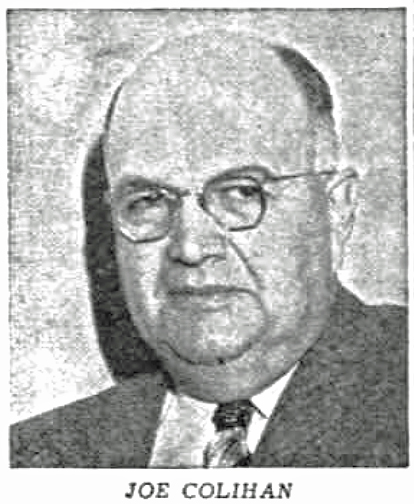
Joe Colihan, 1949. Photo from profile in Billboard
To house his new assistant manager and Bill Clapp, Pearce purchased the Wyer-Pearce House, an 1887 Victorian affair, in 1930 from the streetcar company. The house (now on the National Register of Historic Places) was located on the Park grounds.
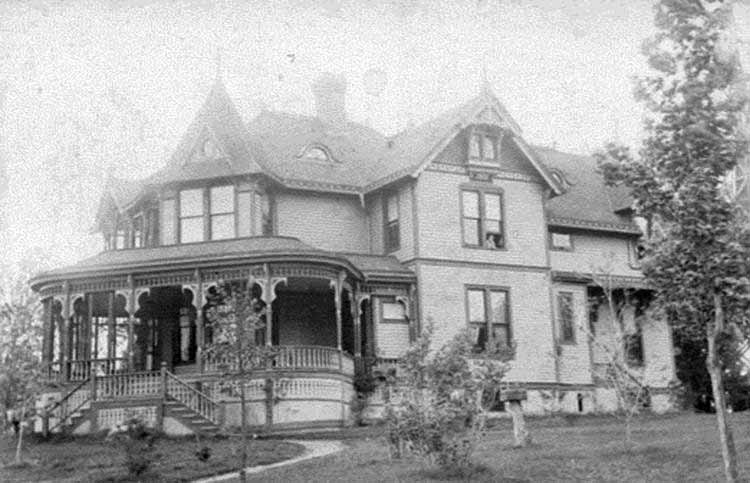
Wyer-Pearce House, 1894. Photo courtesy the Excelsior-Lake Minnetonka Historical Society
Joe died on October 12, 1961, at age 65.
RAY COLIHAN – “BIG REGGIE”
Living on the grounds allowed young Ray to be around the Park as far back as he could remember. His first official job was sweeping the ballroom floor at age 12. Connie Hechter reported that Ray’s first job was running the hat check concession at the ballroom. Once he admitted to sneaking on stage to play Gene Krupa’s drums when nobody was around. As he entered high school, he ran the Ferris wheel and did other jobs.
Ray served in the Army in Japan from 1950 to 1953. His friend Al Anderson says that part of the time he was assigned as a clerk in the Army stockade in Tokyo. When he returned he became the manager of the 7-Hi Drive-in Theater in Hopkins (Record, August 19, 1965), and the manager of an indoor theater in St. Paul. Upon the death of Rudy Shogran on April 8, 1957, Ray was named his successor as the Park’s public relations director and booker of the ballroom.
Note: In a couple of articles, Ray’s birth name is given as “Omri Cole Hann.” In an email dated October 3, 2022, Ray’s son Joe wrote that this is a mistake, and that his father was 100 Percent Irish.
BIG REGGIE’S DANCELAND
The dates are vague here, but my best guess is that in late 1960, Ray re-opened the ballroom, with teen-age dances on Tuesday nights. Friday nights were for “old-time music” and Saturday nights were Dixieland.
In August I lost $4,000; the only time I made any money was Tuesday nights. I made a hundred dollars on Tuesdays with the kids. So I got smart in August and I went every night with teen-age, and I wound up the year not losing anything. The last dance I had that year was Conway Twitty and I put 1,800 kids in there at a buck a head. No one had seen that kind of action since Lawrence Welk played the ballroom. The old man couldn’t believe it. The next year [1961] I got smarter and booked Mike Waggoner and the Bops and I kept it open until ’67.
When his father died on October 19, 1961, Ray took over his job as manager of the Park, and also leased the dormant ballroom as a sideline. He dubbed the ballroom “Big Reggie’s Danceland” – his nickname Big Reggie was named for Jackie Gleason’s Reginald Van Gleason character.
The Underbeats remembered that Big Reggie always wanted to sing “Cottonfields” with them on stage at the beginning of the night– he even made a record of the song, backed with “Tutti Frutti.” The record goes for big bucks today!
On the topic of music, Reggie’s son Joe says:
He was a rocker. He was most into Jerry Lee Lewis, Ray Charles, etc. He even loved that Meatloaf song about being together forever “will ya love me forever” and the Joe Walsh song about “everybody’s so different, I haven’t changed.” He loved all that stuff much more than anything else.
In 1964, the Star’s Bob Murphy noted that Reggie could be spotted at the Kashmiri Lounge at the Ambassador Motor Inn in St. Louis Park, “bending his arm to do a duet or two with Ruth Sneen, the pianist there. The two achieve a remarkable blend of voices. I didn’t even know he sang.”
Big Reggie promoted other shows, notably the Beatles’ appearance at Met Stadium in 1965.
He also brought the hugely popular Dave Clark Five to the Minneapolis Armory on November 17, 1964. On December 12, 1964, Billboard Magazine reported that the group grossed $10,000 but Big Reggie lost $4,000; he had paid $25,000 for two shows, one in Des Moines. Gregory Dee and the Avanties were remembered as the opening act.
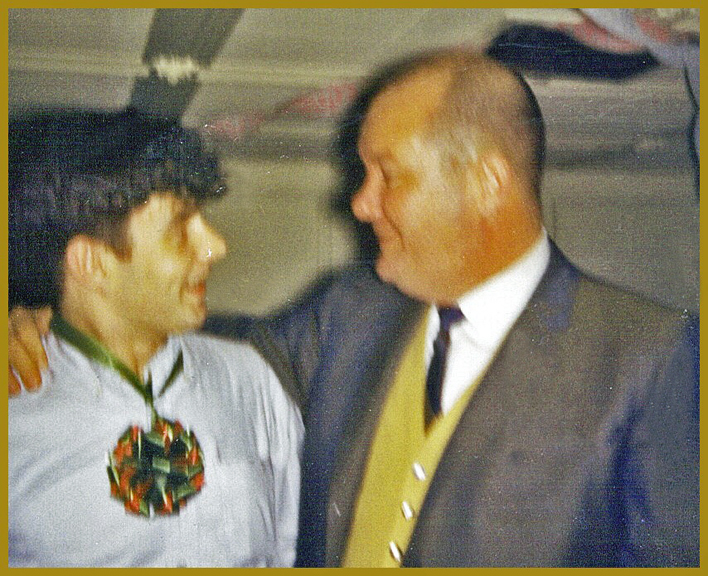
Greg Meland of the Avanties with Big Reggie – photo courtesy Rod Eaton
REGGIE AFTER DANCELAND
After the Park closed, Big Reggie worked as a broker, bringing buyers and sellers of bars together. These are some that he was personally involved with:
In 1970 Reggie partnered with twins Billy and Jimmy Robertson of the Minnesota Twins and built the Twins Stagecoach Inn, a bar/restaurant next to the Stagecoach museum in Shakopee. This venue was renamed the 1 and 44 just two years later, so apparently it was not a success.
REGGIE’S BAR
In 1973 Reggie bought and operated Reggie’s Bar in downtown St. Cloud. Starting in about mid April, the bar presented a noontime lingerie show that attracted full houses. In June,
local priests and members of the local Knights of Columbus appealed to the City Council to put a stop to the shows. On Sunday, notices appeared in bulletins issued by every Catholic church in the area, stating that a “filthy sex show” was being presented at a local bar and urged parish members to voice their disapproval to St. Cloud Mayor Al Loehr and the Council. (Minneapolis Tribune, June 20, 1973)
Although Reggie couldn’t have bought better publicity, the threat of action by the City Council to prohibit such shows led him to put an end to the shows.
Reggie’s Bar was destroyed by fire on February 24, 1974, causing $140,000 in damages. Assistant State Fire Marshall Richard Polipnick accused Reggie of starting the fire, and bound him over to the Stearns District Court on charges of arson and insurance fraud. He was freed on his own recognizance after a preliminary hearing. Reggie was granted a change in venue and pleaded innocent to the charges. He was tried by a jury in Little Falls, Morrison County and found not guilty on May 8, 1975.
Reggie was manager of La Cantina, located at 7800 Computer Ave. in Bloomington. La Cantina was built by Pat Moore. Reggie resigned in October 1974 amid a fight with the Bloomington City Council over the percentage of food to liquor sold at the restaurant and nightclub.
Here’s a special event Reggie organized at La Cantina for his former teenagers:
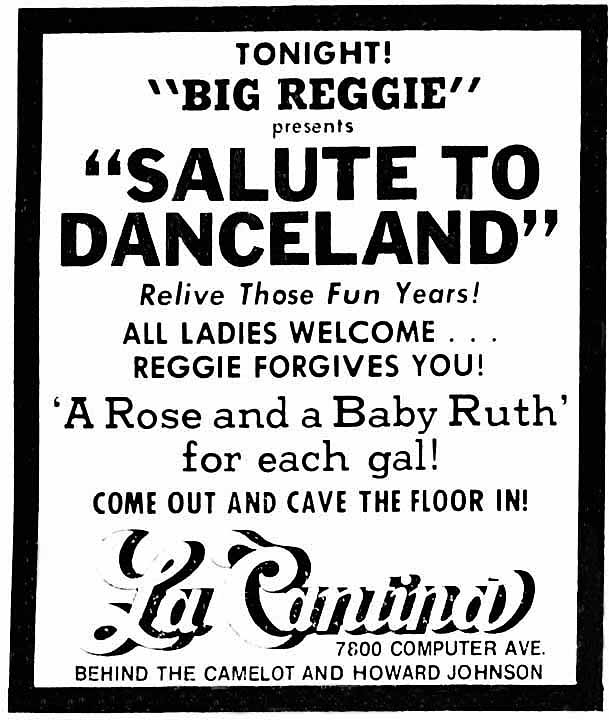
Minneapolis Tribune, March 12, 1974
SKYWAY BAR
In the late 1970s, Reggie owned and managed the Skyway Bar (by 1986 known as Reggie’s Downtown) at 8th and Hennepin.
Reggie purchased the Uptown Bar at Lake and Hennepin in 1984, with partner Jim Loosen. During his two year tenure, the bar became a mecca for punk/alternative local bands,
GOODBYE TO BIG REGGIE
Raymond “Big Reggie” Colihan died on November 18, 1986, at his Edina home from cancer at the age of 58. He was survived by his wife, Beverly Ann; daughter, Cathleen Ann (David Rand); son, Joseph Patrick Colihan; and mother, Marion.
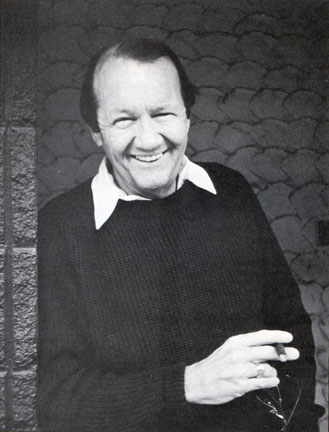
SOURCES
MINNEAPOLIS STAR AND TRIBUNE
Will Jones item: May 23, 1961
School Night at Excelsior: May 13, 1961
Will Jones: June 26, 1961
20 Dance Halls Lose Bottle Club Licenses: August 25, 1961
Suburban Neighbors column by Ralph Thornton: September 14, 1963
Don Morrison’s 2 Cents’ Worth; Beatles Want Bigger Bite From Promoter: May 28, 1964
Court Clears Youth of 3 Charges: June 26, 1965
Dance Hall’s License Suspended: April 22, 1966
Excelsior Sets Hearing on License Suspension: April 26, 1966
Hearing Held Wednesday on Danceland: April 28, 1966
Excelsior Plans to Review Suspension: April 30, 1966
Excelsior Lifts Ban on Dancehall: May 5, 1966
Danceland to Reopen – With Curbs: May 6, 1966
Fire destroys hall where Welk, Stones once played, by Jack Coffman: July 9, 1973
Long Lake Man Charged in Hall Fire: July 10, 1973
Area gives Beach Boys good vibrations by Michael Anthony: August 5, 1976
MINNEAPOLIS DAILY HERALD – All dates 1962
Ads: May 10 and 30, July 2, September 9
Holiday Fireworks at Amusement Park: May 24
Fireworks at Park Set For July 3-4
MINNETONKA HERALD
Excelsior Suspends Danceland License: April 21, 1966
Danceland License Returned: May 5, 1966
Park Now Open on Weekends Only: September 7, 1967
Summer’s Over – Amusement Park is Closing: September 14, 1967
MINNETONKA RECORD
Excelsior Park To Open Sunday in Pre-Season Series: April 1963
Excelsior Park Hosts Hi School Night Friday: May 1963
Excelsior, Park Officials Discuss Petition Complaint: May 30, 1963
Excelsior Park To Open On Weekend: April 23, 1964
Sky-Divers And Fireworks At Excelsior Park: July 2, 1964
Amusement Park Observes Fortieth Anniversary In ’65: May 27, 1965
Danceland Policing Discussed: May 27, 1965
Excelsior Charged with negligence in $100,000 Claim: May 26, 1966
Danceland to Open Next Friday Night: April 20, 1967
Danceland Licenses Requested: April 21, 1968
MINNETONKA SUN
Danceland on Excelsior Agenda Monday: May 9, 1968
Danceland Will Close: May 16, 1968
EXCELSIOR-DEEPHAVEN SUN: All July 12, 1973
- Danceland turns to smoking hull
- Long Lake man arrested in fire investigation
- Sweet nostalgia destroyed in a few, scorching hours
Sweet Potato: Daniel Gabriel, July 22, 1981
Insider: “Big Reggie: The World’s Oldest Teenager!” by Connie Hechter, September 1974
Dania Hall was located at 427 Cedar Ave. So. on the West Bank in Minneapolis.
CONSTRUCTION
The Hall was built in 1886 by the Dania Hall Building Association, which was in turn founded by Society Dania, an organization of Danish immigrants that helped other young Danes adjust to their new city. Dania hall was conceived to be a meeting place and cultural center. The land was sold to the Society by Louis Meldal, a one-time president of the organization, for $11,000. The Society hired Norwegian architect Carl Struck to design the building; Struck used a Victorian Eclectic design, combining Gothic and classical styles. The cornerstone was laid on June 5, 1886, Danish Independence Day, celebrated with a march and speakers. The completed building was dedicated on November 10, 1886, celebrated by 300 Danes, according to the Minneapolis Tribune.
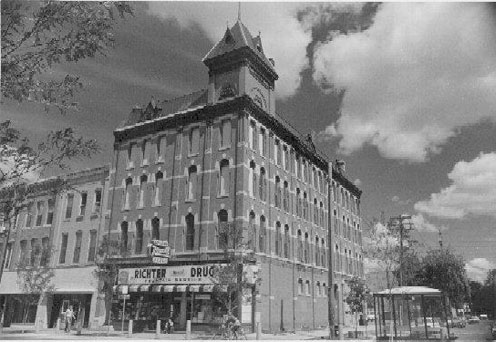
Dania Hall, courtesy Hennepin County Library, Minneapolis Collection.
The building had four stories and a basement:
- The basement held offices, a kitchen, a dining hall, and J.M. Jackson’s Barber Shop.
- There were two storefronts on the first floor.
- The second floor housed six offices, including the office of the Society Dania, along with a billiard room, a library, a small hall with a stage, and the Society Dania fraternal rooms.
- The third floor was an open room 44 feet wide, 65 feet long, and 23 feet high, with a proscenium stage. 600 people could be seated on chairs. The curtain read Ej Blot Til Lyst (not for fun only), as did the curtain at the Royal Theatre in Copenhagen. The third floor was rented out for parties, dances, and where people went to see plays and vaudeville shows, often in their own Scandinavian languages.
- The fourth floor was a horseshoe-shaped balcony overlooking the third floor. It could seat 200 people.
The main entrance was on Fifth Street. Patrons entered through wrought iron gates with gaslit torches on either side. A wide wooden staircase led to the upper floors.
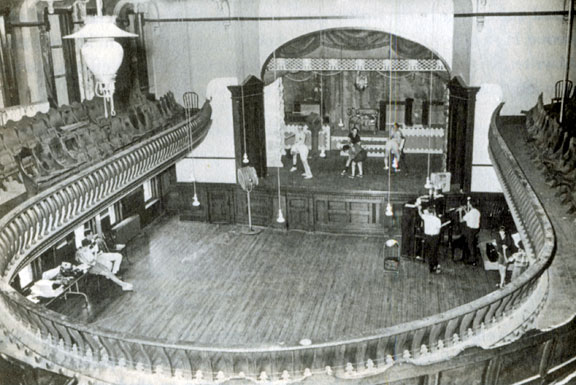
Interior of Dania Hall’s third floor theater and fourth floor balcony, 1969. Original gas chandelier still in place.
In 1896, the Society Dania purchased the building from the Building Association for $23,300, the amount of the remaining debt. The total cost of the building and land was $35,000.
1963
PHIL RICHTER
The story of the modern Dania Hall is really the story of pharmacist Phillip Jerome Richter. Richter was born on December 4, 1921, and grew up in North Minneapolis, graduating from North High. After graduating from pharmacy school at the University of Minnesota, he enlisted in the Army in 1944, where he worked with wounded and mentally ill soldiers in crowded hospital ships ferrying World War II troops back to the United States from the South Pacific.
He worked for another druggist for two years at 34th Ave. and 50th Street, and bought the drug store at Dania Hall from Seiver J. Moe in 1948. Moe had operated a hardware store in the other storefront on the first floor. The spot where Richter established Richter’s Rexall Drugs had been a drug store since about 1910. In 1963, Richter bought the building from Society Dania for $35,000. The Society Dania continued to use part of the building as a lodge hall.
Richter took a tolerant attitude toward the hippies and the bikers who congregated at his store, letting them use the phone, acting as an ad hoc doctor, lending money, holding their mail, etc. The store became what one underground newspaper dubbed the Heart of the West Bank.
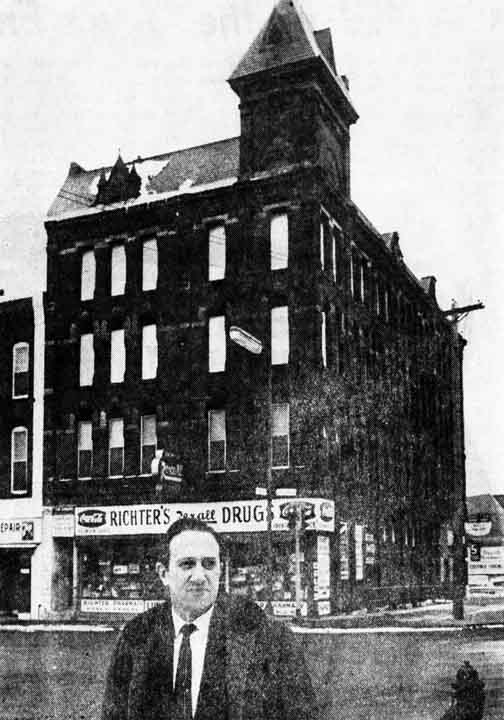
Minneapolis Tribune photo by Dwight Miller, January 12, 1968
1964
MODERN DANCE
An article calling the hall “one of the oldest surviving vaudeville theaters in Minneapolis” announced that the Paul Taylor Dance Company was coming to teach a series of master classes sponsored by the Walker Art Center from August 10 to September 2, 1964. The classes were funded by a Rockefeller Foundation grant to the Walker.
Two events were scheduled in conjunction with the workshop:
- A lighting demonstration by New York set designer Tom Skelton
- A public concert by the Paul Taylor Company on August 30, 1964.
The article said that a gas lamp hangs from the domed ceiling, there are pulleys without ropes, painted sets leaning in dark corners, and a sign that strictly prohibited smoking and spitting. (Minneapolis Tribune, July 23, 1964)
1965
THE PLAY’S THE THING
In August 1965, the third floor theater, which hadn’t been used for a play in 30 years, was revived as a dramatic venue by the K & S Theater Players, headed by Steven Katz of St. Louis Park. The troupe had staged nine plays in different venues around town before settling in at Dania. Their first play at Dania was “Once Upon a Mattress” on August 5 – 8.
In his column, Don Morrison describes the scene:
The staged is framed with an ornate arch. The main drop curtain, which rolls down like a porch blind, probably had not been lowered for three decads and released a Niagara of accumulated dirt when the K & S people first tried it out. It bears a lugubrious postcard landscape of a castle, a lake and forested mountains. Danish, no doubt.
Backstage, the old scenery flats bear the scribbled names of theatrical greats who have played the Dania. I rather liked the proud blazon of the “Budapest Gypsies – April 17, 1936.” Among the roster of names was one Gypsy Yancho. Also is the despairing heartcry possibly written on the wall by an actor fallen from eminence: “O temore, O mores!”
Among unusual features of the Dania theater is a gas kitchen range in the ladies room – formerly utilized, I am told, for making tea.
(Minneapolis Star, July 14, 1965)
AND SO IT BEGINS
Richter remembered that the “weird people” began to show up in 1965, while he and his family were on a three week vacation to Mexico. When he returned, he asked employee Patricia Drake what she had done to his store. He said that many of the people who came were looking for drugs: “The only thing that irritated me about the drug business was they did more business than I did. The rolls these kids had were just fabulous.” The other major group were the bikers, who “were here for mostly one thing: s-e-x. There were a lot of runaways here on the West Bank.”
The 1965 date may have coincided with the new Washington Ave. bridge across the Mississippi River. The first University of Minnesota buildings appeared on the West Bank in 1961 (Walter W. Heller Hall) and 1962 (Blegen Hall and the Social Sciences Building).
1967
Columnist Barbara Flanagan mused, “I wish that somebody cared about good old Dania Hall.. It would take some doing, but it could be a showplace again the way it was when the Danes moved in.” She was given a tour by the live-in caretakers, Mr. and Mrs. Axel Christensen, who told her that the gas chandelier was the oldest gas lamp in the City and the gas company “would sure like to get their hands on it.” The building was still used as a meeting place for members of the Dania Lodge, and it was a rehearsal space for groups such as the Edgewater Eight. When asked if there was a Dania Hall ghost, Mrs. Christensen said, “I don’t know, but I do hear an occasional creaking at night.” (Minneapolis Star, December 15, 1967)
CONCERTS AT DANIA HALL
The building’s ballroom and its proximity to the U of M made it a logical venue for rock concerts. Only the roadies who had to haul the equipment up the stairs questioned the perfection of the venue. Dania Hall became the first of a progression of venues for late ’60s and late ’70s rock that continued with the Labor Temple and then the Depot.
In about in 1966, Gary Dale had a light show company called Light Fantastic, and every other week his show appeared with the Paisleys. Other names associated with Gary Dale were Dick Tatge, and Lee Fletcher.
On alternate weeks, Charlie Campbell’s Community News light show presented its own bands.
In June 1968, Gary and the Paisleys went to Canada, and, with Gary’s permission, Steve Barich took over the Light Fantastic name and did light shows and bookings.
Paisleys band member Peter Larsen told minniepaulmusic.com about the early days at Dania Hall:
The hall had a history to it. There were names inscribed all over the back of the stage that go back to the beginning of the theater. You felt a presence, even with no people there. There was a warmth… a character to the hall, the smell of the wood… all of the timber and resonating of the wood lent itself to the performance. These were the physical things and then there was the invisible that went along with this… a spirituality. It was built as a place for people to gather, to share and to communicate. If you were going to perform, that was the place to perform. It was a different awakening or happening.
The ambience and the sound contributed to this incredible atmosphere and it resonated with the music and the people. It was an open theater, one of the only kind in the city. It was a unique building. I just felt at home there with what we were doing back then.
Because of the incense and the beads, it was like going to church. It was akin to a religious experience.
Other bands that played the hall included:
- Noah’s Ark
- T.B.I. (True Blues Inc.)
- Jokers Wild
- Pepper Fog
- The Litter
- Lightning
- Pandemonium Side Show
- Mill City Blues Band
- Nicollet Island Peep Show
- Cold Duck
- Blue Sandalwood Soap
Finding information about these concerts is difficult; because building owner Phil Richter did not have a dance hall license, it was dangerous to advertise. Also, Steve Barich noted that there was no advertising budget… When one of the groups wanted to advertise, Richter applied for and received a dance hall license on December 29, 1967. At that time the building was inspected, and Richter was made to fix some cracked plaster over an unused balcony before the permit was approved.
ALDERMAN CHRISTENSEN ON THE WARPATH
Then on December 30, 1967, Alderman Jens Christensen attended one of two dances held at the hall, and when he got home he got a phone call from “a concerned citizen” who alerted him to two “fire hazards:” a door was locked to keep the second and third floor groups apart, and decorative plastic sheets that were hung from the balcony obscured exit signs. Based on this, Christensen ordered a top-to-bottom inspection, including plumbing, electrical, fire, and structural hazards. Inspection officials told Christensen that the initial complaints were outside the department’s jurisdiction. Richter accused Christensen of harassing him in order to get him to sell his building, presumably to Gloria Segal, who was redeveloping much of the West Bank. Keith Heller, Segal’s partner, denied this accusation.
1968
DANIA DANCES ARE HAPPENINGS
An article in the Minneapolis Star (February 8, 1968) brought the Wednesday and Friday night concerts by the Paisleys to the attention of Mr. and Mrs. Minneapolis, with the headline, “Dania Hall Dances Are ‘Happenings.'” The article stressed the fellowship aspect of the event witnessed by the unnamed reporter. Police officer Donald Reynolds, who worked at the dances three nights a week, said:
They’re a group apart alright. You should see them Friday or Saturday night. Three or four hundred come, and they wear costumes – rebel outfits, hats, and weird coats. But these dances, with as many kids as there are, are less trouble than I’ve ever had bouncing at bars.
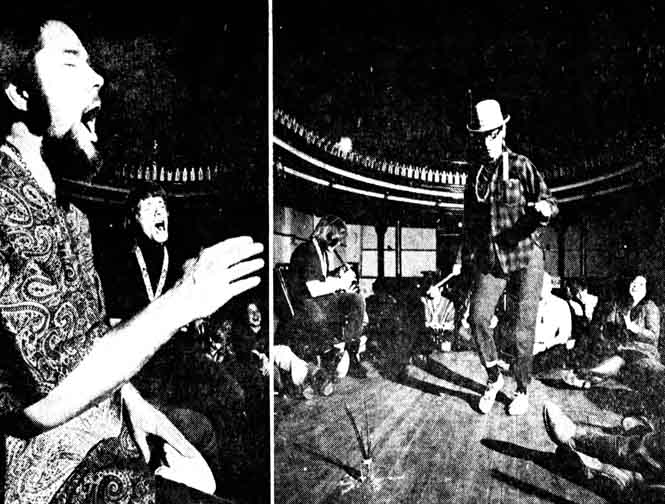
Minneapolis Star, February 8, 1968
The caption for the photo above read:
The Paisleys, a Rock Group, staged a psychedelic happening in Dania Hall. Lights flashed, participants played flutes, drums and a sitar.
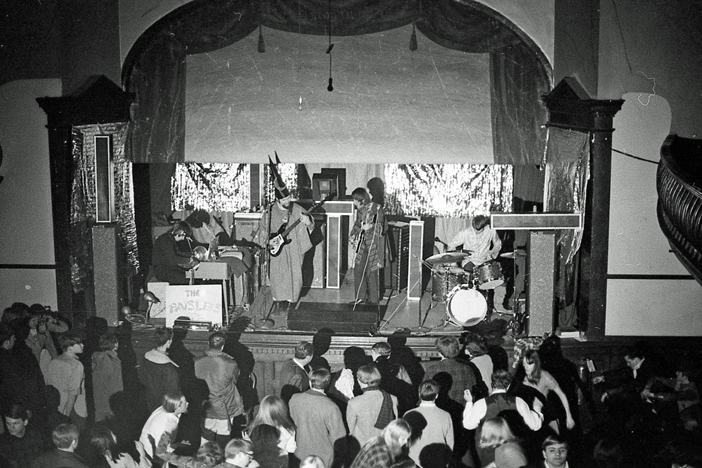
The Paisleys, March 1968. Photo courtesy minniepaulmusic.com
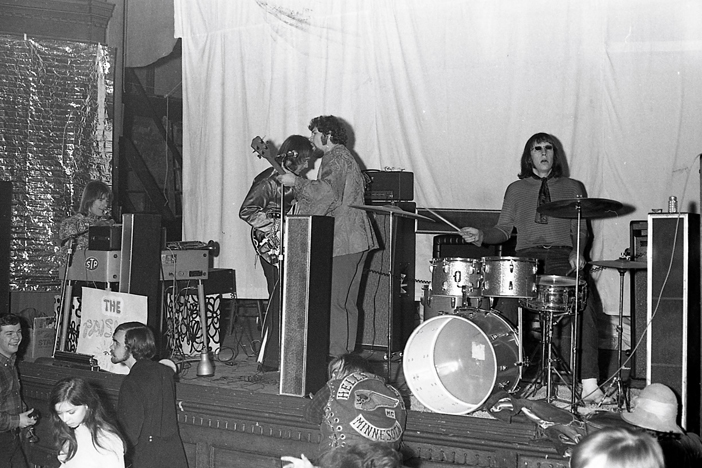
The Paisleys, April 19, 1968. Note Hell’s Angel in front. Photo courtesy minniepaulmusic.com
From March 17 to May 1968, Dania Hall was included in a list of Under 21 Dance Spots, open every Friday from 8:30 to 12:30.
CHRISTENSEN AT IT AGAIN
On June 12, 1968, complaints about the dances were heard by the Minneapolis City Council Licenses Committee. Alderman Jens Christensen wanted the the committee to deny the renewal of the dance hall license because he had received numerous complaints about “noise, crowds congregating on the sidewalk outside the hall and the use of vulgar language.” He quoted from an article in the Minnesota Daily, published on May 22, 1968, which quoted the manager of a dance group:
The audience is allowed to be uninhibited. At many places, cops really hassle the kids. At one place we played, two kids were necking and a cop kicked them out. At Dania everyone does what he wants.
Richter was asked to appear before the committee and show cause why the license should not be denied. (Minneapolis Star, June 12, 1968)
Meanwhile, a “Dance and Light Show” was held on June 25, 1968 – a benefit for the Twin Cities Draft Information Center.
CHARLIE THE NARC BURIES DANIA DANCES
Thanks to the testimony of 22-year-old undercover cop Wayne Billings (known by the kids as “Charlie”) before the City Council’s Licenses Committee, the committee voted to recommend to the City Council that the license not be renewed. Charlie stated that he was told that Dania was “the best place in town to make contacts for buying and selling marijuana and other drugs.”
Some local residents were in favor of the closing: “Those hippies play weird music until all hours of the night,” said a boarding house owner. A middle-aged boarder said “those hippies have been making too damn much racket.”
Not everyone wanted the hall closed. A 70-year-old lady “couldn’t understand what all the fuss was about:”
I’ve never been in the hall, but it’s nice and the city is making a big mistake by closing it because there’s a terrible need down here for recreation centers. They let all these liquor licenses stay around here but they don’t leave places for the kids.
There was a difference of opinion as to whether drug purchases were being made inside the hall or were restricted to on the street. Billings testified that he had witnessed purchases inside.
(Minneapolis Tribune, June 27, 1968)
True to form, after hearing testimony from Billings, the City Council took the License Committee’s recommendation and denied renewal of Dania’s dance-hall license with a unanimous vote. (Minneapolis Star, June 28, 1968).
Owner Phillip J. Richter said the Council’s denial of the license would force him to sell the building. (Minneapolis Tribune, June 29, 1968)
NB: I tried to find out whatever happened to our Mr. Billings, but it so happens that there are a lot of people by that name in Minnesota who would be around his age, so if you meet up with one, don’t assume it’s Charlie the Narc!
On June 30, 1968, a classified ad offered:
DANCING – Free bev. July 3rd, 9 – 1 p.m. with the Indigo Outlet. $3 singles $4 cpl. Must be 21.
PROTEST
Things got tense on July 3, 1968, when about 200 young people assembled at the Electric Fetus, then located at 521 Cedar Ave., to protest the closing of Dania Hall. Apparently the protest consisted of dancing in an empty lot. About ten Minneapolis cops, two squad cars, and a paddy wagon confronted them from across the street. In the end, the cops left with “flowers in their lapels, “Save Cedar-Riverside” buttons in their hats – and an empty paddy wagon.”
Patrolman Jack McKelvey was quoted as saying “Those kids have a point. Dania shouldn’t be closed. I’ve worked up there and I know that nothing goes on. I’ve never seen anything against the law happen there. You’ve got a good group there. Organize and go before the Council. If he (Christensen) is pressured enough, he’ll change. But if you go out and break the law today, you hurt your cause.” (Minneapolis Tribune, July 4, 1968)
HIPPIES AND RICHTER’S
In mid-August, 1968, Richter was interviewed by the Rick Edmonds of the Tribune about the hippies that congregated at his drugstore, which Edmonds termed the heart of West Bank life, and Richter called “the Hollywood and Vine of hippiedom.” Richter noted that two years ago, the clientele had been university students who had a bit of money to spend at the soda fountain, but now the kids were younger – “hippie-boppers,” he called them – who were more inclined to panhandle. They would congregate in front of the store in groups of 20 to up to 100 at a time, with police occasionally coming to shoo them away. Richter fretted that they were scaring off his regular customers, although they certainly didn’t hurt anyone. And he didn’t think drugs were much of an issue because they couldn’t afford them.
“These kids have love, you’ve got to give them that – love, and peace and freedom,” he said, preferring them to the drunks that used to inhabit Cedar Ave. Just the same, he hoped they would go home and back to school in September. (Minneapolis Tribune, August 14, 1968)
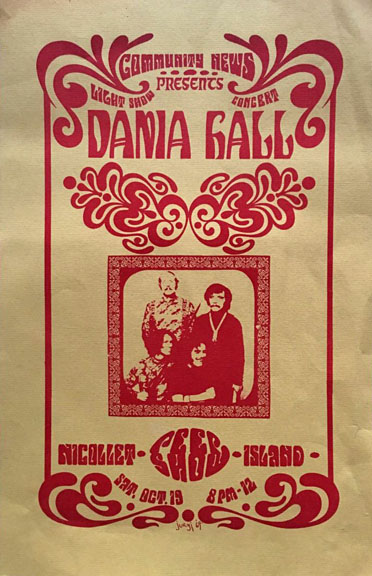
Nicollet Island Peep Show, October 19, 1968. Poster by George Ostrushko
LSD NEWLY ILLEGAL
In October 1968, an 18-year-old young man from Richfield was charged with a gross misdemeanor under a new state law which prohibited the possession of LSD. The man was arrested at Dania Hall with a small plastic bottle that was analyzed and found to be the recently banned substance. The lad was given two years probation. The first states to make LSD illegal were Nevada and California in 1966. (Minneapolis Star, October 23, 1968)
RICHTER SELLS
In November 1968, Richter sold the building to Cedar Riverside Associates, “owner of considerable property in the Cedar Riverside area,” and the building was in danger of being part of a sweeping urban renewal scheme. Richter was given a long-term lease to continue running his drug store on the ground floor.
Cedar Riverside Associates was operated by Mrs. Gloria Segal, a future State legislator, and Keith Heller, a former economics professor at the U of M. At the time the firm had control of about 700 dwelling units in the area, and were hoping to come up with a plan for rehabilitation of the area by private enterprise. (Minneapolis Star, November 22, 1968)
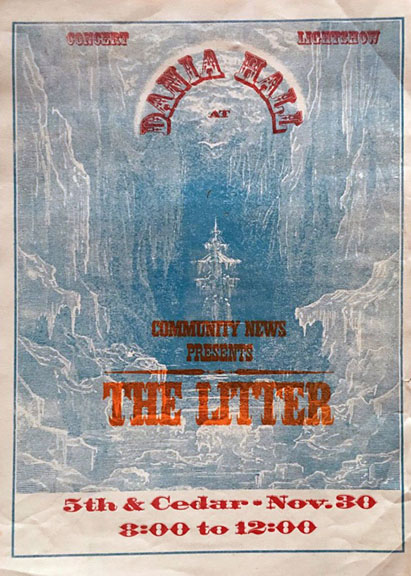
The Litter, November 30, 1968. Poster by George Ostrushko
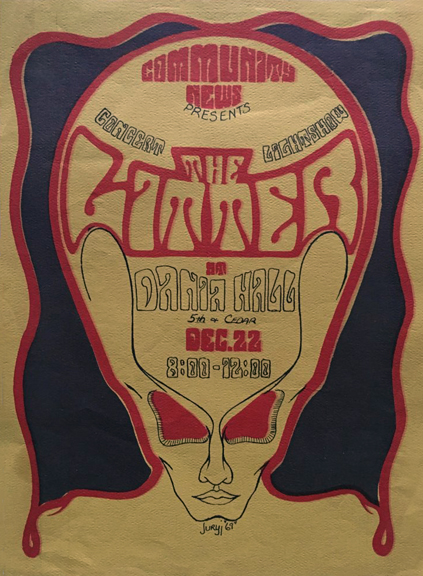
The Litter, December 22, 1968. Poster by George Ostroushko
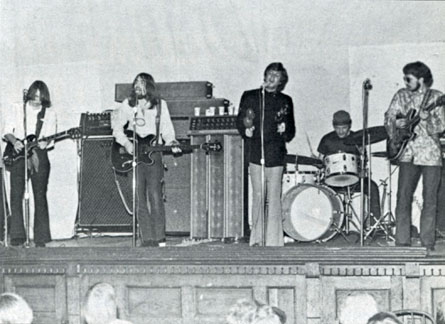
Zarathustra, December 28, 1968. Thanks to Bob Coates (on far right) for clarification!
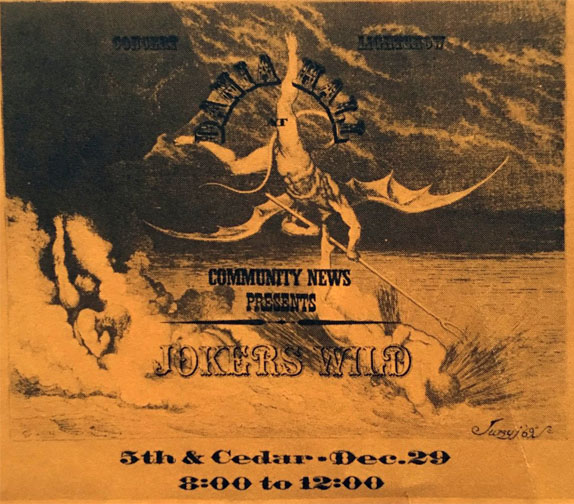
Jokers Wild, December 29, 1968. Poster by George Ostrushko
1969
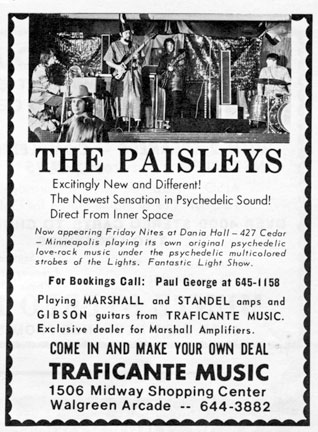
Paisleys ad from March 16-23, 1969 Insider
DRUG RAIDS CONTINUE
On May 24, 1969, the Minneapolis narcotics squad surrounded Dania Hall, looking for drugs and drug users. They converged on a hearse in the back of the building. Bystanders jeered the narcs and the newsmen reporting on the bust. Arrested were one 22-year-old man, a 16-year-old from St. Louis Park with a record; a 15 year-old girl; and a 13-year-old boy who threatened to shoot the police with a toy gun. Police confiscated about 400 capsules of suspected LSD and a small quantity of hashish. (Minneapolis Star and Tribune, May 26, 1969)
This is not the third floor stage – is it the second floor or a different venue altogether?
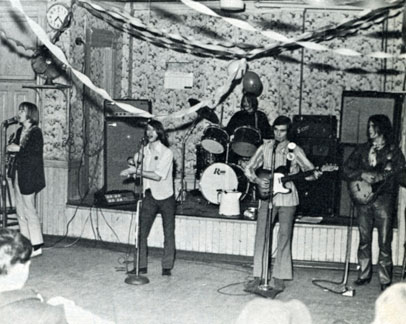
Poison Bird Pie, 1969. Photo copyright Mike Barich, St. Paul. Caption in the Insider: “Band has a lot of promise.”
1970
In 1970 the building was owned by University Community Properties. Concerts were on again, including:
- February 15, 1970: Gas, Food, and Lodging
- February 22, 1970: Bamboo
- March 14, 1970: Bamboo and Mama’s Home Cookin’ – Brought to you by Green Toad Productions
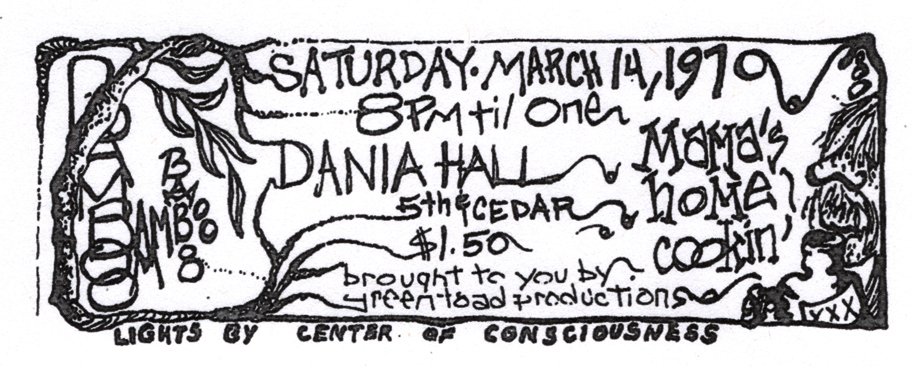
Bamboo, Mama’s Home Cookin’, March 14, 1970. Ad from Minneapolis Flag
On April 4, 1970, artist Robert Rauschenberg opened his exhibition at Dayton’s Gallery 12 and held the after party at Dania Hall. Joker’s Wild provided the entertainment. The turnout was far greater than expected! (Minneapolis Tribune, April 7, 1970)
On May 1, 1970, a benefit party was planned at Dania Hall to raise money for the Black Panther Party defense fund. The benefit was sponsored by the Minneapolis Committee to Fight Repression, and activities included a light show by Center of Consciousness. Admission was $2. (Minneapolis Star, May 1, 1970)
1972
Barbara Flanagan reported that the building had been recently sandblasted in the summer of 1972.
1973
By 1973 the building was practically abandoned. The Weaver’s Guild occupied the second floor until at least until 1979.
1975
In 1975, with the help of the Danish American Fellowship and the Minnesota Historical Society, the building was put on the National Registry of Historic Places, giving it some measure of protection.
1978
Concerts resumed in 1978:
- Ambrose and Spooks: June 30
- Ambrose: July 7, 14, 21, 28
- Benefit for the Cedar-Lake Childcare Cooperative:
- Jerry Rau
- Jim Price
- Yata
- Pop Wagner
- Dick Rees
- D.G. Peterson
- Maureen McElderry
- Jeff Jordorff
- Bill Hinkley
- Judy Larson
- Barb With
- Willie Murphy and the Bees: September 15
- Willie Murphy and the Bees: September 16 – Benefit for KFAI
- Shangoya: September 22, 1978
- Rio Nido and the Radio Rangers – Hot Boogie Rent Party Benefit Dance: December 15
- Shangoya: Benefit for Sez – book of poetry: December 15, 1978
1979
- Shangoya: January 19, 1979 – Benefit for National Lawyer’s Guild
- D’Gadband: Dance for an alternative energy project: March 17, 1979
- The Wolverines: Benefit for Heart of the Beast/Powderhorn Puppet Theatre: April 13, 1979
- Explodo Boys and Good Foot: May 29, 1979
Even in the later days, musicians loved to play at Dania Hall. Johnny Hanson remembers, “The hand-carved horseshoe balcony was one of a kind…old-school craftsmanship and the room sang like a violin… just the right size…the room sang like a bird…all that wood vibrating with a crowd in a groove was one of a kind…indeed… ”
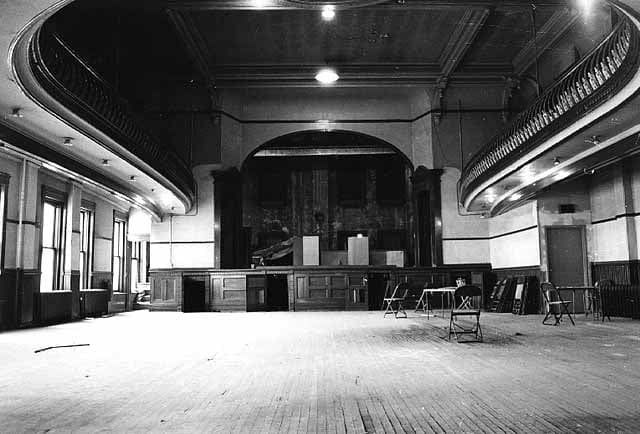
View of the third floor, under the balcony. August 1974 photo courtesy Minnesota Historical Society
1980
Told that he had a bad heart, Richter reluctantly sold his drug store and moved to Florida. Although he was given only two years to live, he had a quintuple bypass operation and lived another 22 years.
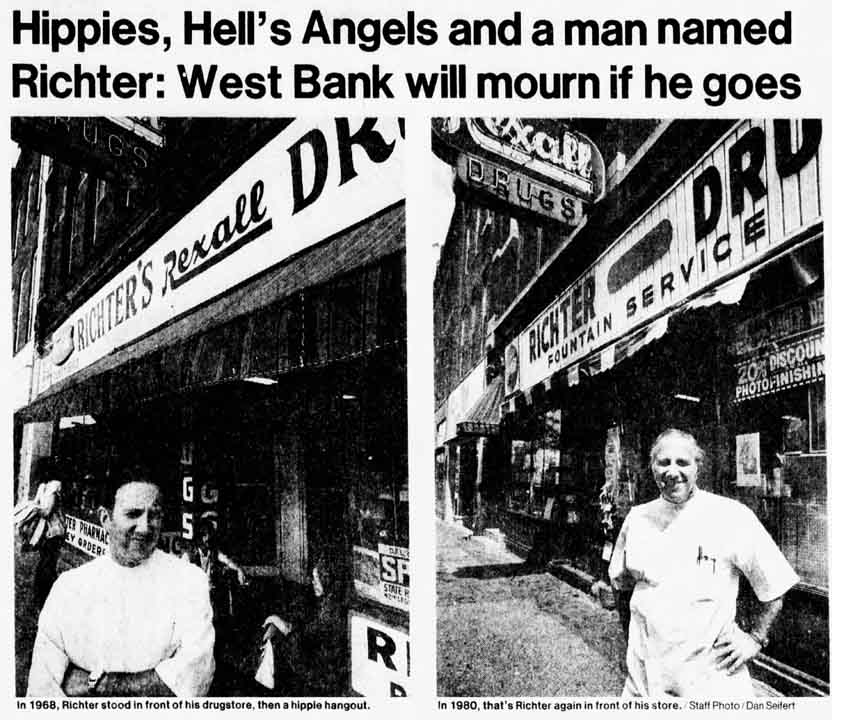
Minneapolis Tribune, May 17, 1980
1986
The building was acquired by the Minneapolis Community Development Agency in 1986.
1987
The West Bank Theatre District celebrated its second anniversary on January 20, 1987, by reopening Dania Hall for one night. Although the building was considered unsafe for performances in its present state, it was approved for the “invitation only” celebration. (Minneapolis Tribune, January 16, 1987)
Only the first and second floors remained in use until 1991.
1991
FIRE PLAGUES THE HALL
On July 18, 1991, an early-morning fire caused extensive damage to the building. The alarm came in just after 6:15 am. It was under control by 7:45 am, but by then the roof had collapsed onto the third/fourth floor theater. The building was unoccupied and there were no injuries.
At the time the only going concerns in the building were:
- A dining hall and communal kitchen in the basement
- The West Bank Pharmacy on the first floor
- Facs, a fundraising and communications service, Terre Thomas, President – first floor
Arson was suspected in that fire after teenagers had been seen inside that night. The building was never used again. There were several plans for redevelopment, but given the building’s historic designation, it had to be restored to its original condition, which was cost prohibitive. The MCDA spent $228,000 to make basic repairs and stabilize the building. (Minneapolis Tribune, July 19, 1991)
1992 Photos from the Library of Congress, courtesy of Lyfmap.com
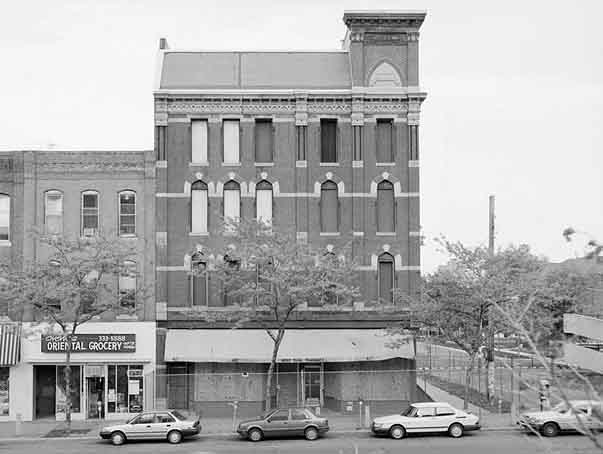
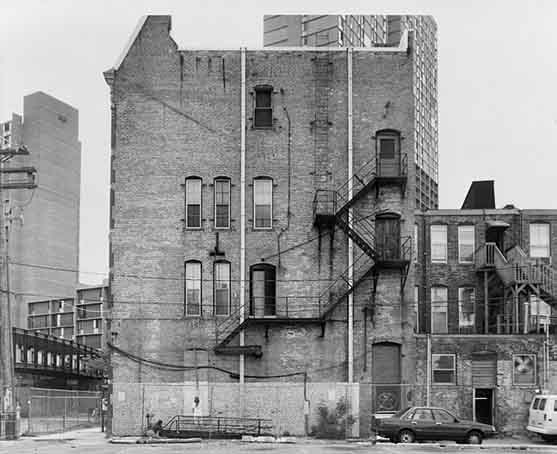
Back of building
2000
DANIA BURNS TO THE GROUND
In 2000 the building was undergoing a $2.7 million renovation to be used as a cultural center with shops and a theater, begun in 1999. But on Monday, February 28, 2000, the Hall burned down in a four-alarm fire that was reported shortly after 1 am. Flames soared 70 feet into the sky and burned for more than four hours; 100 firefighters from 15 stations fought the flames. The fire spread to the adjoining Holtzermann building, forcing more than 50 residents from their apartments; 25 people were made homeless. One business in that building was destroyed and at least five others had smoke damage. The entire four-building complex had to be evacuated for lack of water and gas service. No one was injured.
In the afternoon, the wind knocked the facade down on top of burned-out cars on Cedar Ave. that had been in front of the building, and the block was closed to traffic so workers could demolish the remaining walls. The hall was owned by the Minneapolis Community Development Agency and was self-insured, so the City had to pay for the loss, including the $65,000 it cost for cleanup. The City had been planning to sell the building to private investors in two weeks; the investors would have completed the renovation and would have had insurance. An elevator shaft had just been installed, and sprinklers were planned to be installed within a month. (Minneapolis Star Tribune, February 29, 2000)
Plans for the renovated building had included a nightclub on the street level, offices on the second floor, and a third-floor theater for performances by dance groups. A pizza service was to operate in the basement. (St. Paul Pioneer Press, February 29, 2000)
The fire was attributed to a discarded cigarette; a remorseful drifter was suspected, but his only asset was a pit bull puppy, so there were no actions to charge him. (Star Tribune, March 9, 2000) It was also dubious whether a cigarette could start a wood fire of that magnatude. The cigarette theory was also highly suspect, since two loud bangs that sounded like gunshots were heard before the fire started.
Another disturbing incident was that pieces of charred wood were found on the front porch of Tim Mungavan, executive director of the West Bank Community Development Corp., which was working on the renovation. Since his house was ten blocks from Dania Hall, neither he nor the police had any explanation. (Minneapolis Star Tribune, March 1, 2000)
A neighborhood memorial service to mark the hall’s loss was held at the Cedar Cultural Center on March 2, 2000. (Minneapolis Tribune, March 9, 2000)
2002
Phillip Richter died on December 26, 2002, at the age of 81.
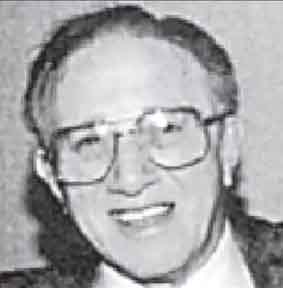
Minneapolis Star Tribune, December 27, 2002
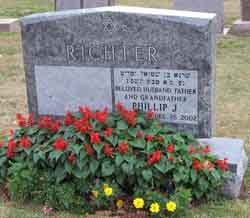
Image courtesy FindaGrave.com
MORE
A complete history of the building is told best in a chapter of the book Swedes in the Twin Cities, edited by Philip J. Anderson and Dag Blanck (2001, MHS Press). The chapter, “Dania Hall: At the Center of a Scandinavian American Community,” was written by David Markle.
Additional sources: “Hippies, Hell’s Angels and a man named Richter: West Bank Will Mourn if he goes:” Tom Sorensen, Minneapolis Tribune, May 17, 1980
There were two locations called Danti’s Bar.
1370-1372 Nicollet Ave., Minneapolis
The building was built in 1922, according to ads.
1923: New Nicollet Cafe (1372)
Confectionery, was sold in 1924. (1370)
1928: Papke’s Pet supply store (1370)
March 1929: Jack’s New Music Store (1370)
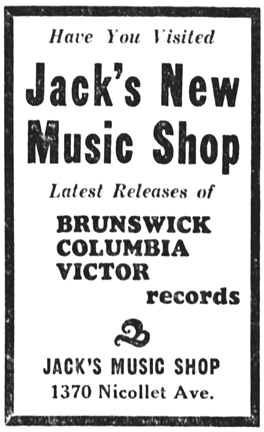
Minneapolis Star, March 21, 1929
December 7, 1929: Minneapolis Shoe Co. (1372)
In April 1933, Sam Kohn got an off and on-sale 3.2 beer license. The tavern and smoke shop owned by Joe Beebe was opposed by neighbors. (1370)
January 30, 1934: Marguerite Dantis: Dantis Cafe; tavern and dance hall. (1372)
In the 1930s the bar had a basketball team in the city league. (1370)
Marguerite Dantis died on January 19, 1938 at age 43. (1372)
The on-sale liquor license of the bar was revoked on April 1, 1940, as a result of gambling violations. It was back open by March 1944.
December 1946 – April 1947: Top Flight Super Valu (1372)
July 1947: Top Flight Cafe (1372)
October 1947 to January 1948: Union Food Market aka UE-CIO Market
June 1948: Ads for waitress, fry cook
September 1948: Owner had to sell cafe
July 1952: Nicollet Dairyway
December 1954: For sale
March 1955: Broiler Burger Shop for sale
September 1958: Loring Liquor Store, headquarters for the Kid Cann Syndicate. Closed March 1961.
August 1964: Chestnut Tree Restaurant to February 1972.
April 9, 1974: Building wrecked, to be replaced by apartments.
1416-1418 Nicollet Ave.
This location was open by July 1946. There seemed to be a regular occurrence of sluggings and muggings at or around the bar.
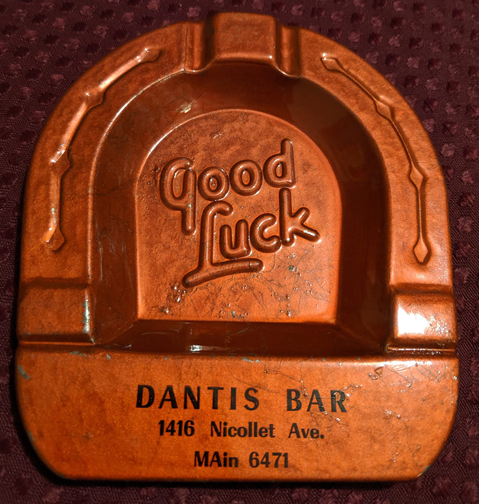
Ashtray image courtesy Bob Jackson
In an article in the Tribune dated January 8, 1956, the owner was identified as Theodore C. Dantis, who was Marguerite’s son.
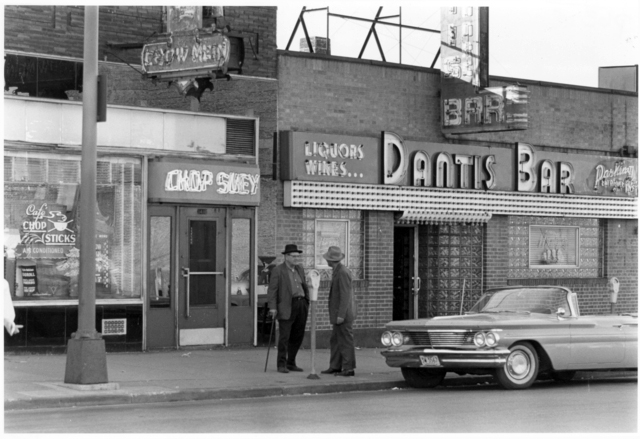
Minnesota Historical Society photo, October 20, 1962
At Loring-Nicollet Krazy Daze in October 1963, Dantis Bar offered special entertainers and “gorgeous entertainers in costumes (?)”
In October 1963, two patrons sued Dantis for being beat up by the sadistic bouncer identified as “Buster.” (Tribune, October 31, 1963)
Dantis went out of business in May 1969, as evidenced by a notice of the sale of the bar’s equipment published on May 16, 1969. The items advertised were:
- 77 ft. bar
- 65 ft. back bar
- 17 booths
- 8 tables
- 32 chairs
- 1 complete serpentine bar
- back bar with two coolers
An article from 1975 about a shooting at the Flame down the street mentions Dantis in the present tense. (Tribune, December 9, 1975)
This building later became the Bowery Boys Co., and in the 1980s the neighbors were up in arms about the establishment’s nude dancing.
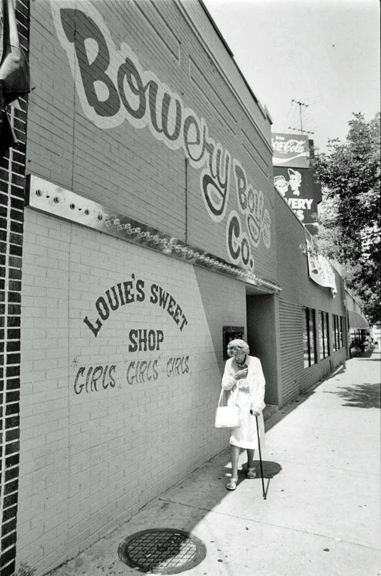
1986 Minnesota Historical Society Photo
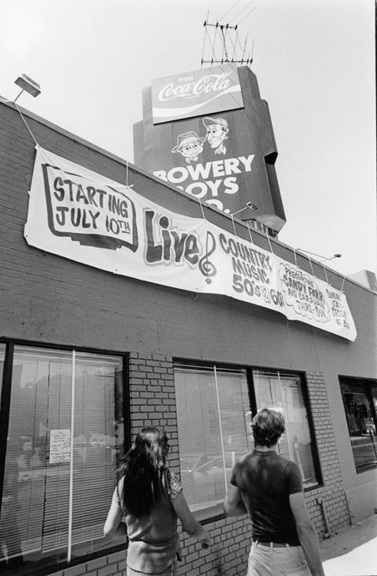
1986 ECCO Photo
Please see More Down Stairs.
Please see Downtowner Motel.
DAYTON’S DEPARTMENT STORE
A true icon in Minneapolis history, Dayton’s was the premiere department store, anchoring the Downtown shopping district. I won’t go into the history of Dayton’s here, but focus on the music that the store brought to the people of the Twin Cities over its many decades. This is by no means a complete list – just… Highlights.
Also see Twin Cities Fashions, when it get it done…
DAYTON’S TEAROOM
In the 1920s, Dayton’s Tearoom had a three-piece band led by Dick Long.
DAYTON’S TOP 10 CLUB
From 1962 to 1966, Dayton’s sponsored a teen dance in their 1,500-seat 8th Floor auditorium, emceed by WDGY disc jockey Bill Diehl. T.J. Skinner attended every Saturday, and said it was extremely popular because it featured live bands instead of records.
By 1964 the dances had gotten to be too popular – one show drew 5,000 kids and got out of control. To regain order the store formed a “Top Ten Teen Club,” limiting dance attendance to 1,500. Billboard Magazine announced that the 1964 shows would be simulcast on WDGY starting on April 4 as “Dayton’s Top 10 Club.”
Mark Riley remembers:
It required a “membership card;” it definitely existed in Spring 1964 (height of Beatlemania); it was a Saturday event held in the Dayton’s auditorium; it probably offered record-purchase discounts for “members;” it may have had a WDGY disk jockey on-site during the show; it definitely distributed “current chart” information, possibly the ‘DGY chart of the week.
An aircheck from www.radiotapes.com in 1964 tells us that there was indeed a simulcast, and that admittance was by club card only, which was free at the teen department at Dayton’s.
At an 8th Floor teen dance at Dayton’s on January 22, 1966, a 14-year-old boy was beaten and kicked as he and three friends were leaving the dance. The same day a store security officer was attacked while trying to control a crowd of about 100 kids on the fifth floor. Minneapolis police pressed Dayton’s to shut down the events, and none were scheduled through February. But they were resumed on March 1 and national acts would be brought in for some of them.
1966
LOU CHRISTIE
On Saturday, May 7th, 1966 (1:30-2 & 3:30-4pm) Lou Christie was one of the performers of that series, backed by the Marvelous Marauders. Marauder Jerry Cadwell reports that it was the first time he ever saw a man put on makeup (the dressing room was in the employee’s men’s room) and it kind of freaked him out! The Seeds and the Electric Prunes also played at Dayton’s that year.
DAYTON’S SUPER YOUTHQUAKE
In May 1966, Stuart Wells, Vice President of Merchandising and Publicity for Dayton’s, visited London and observed the fashions the young people were wearing on Carnaby Street. On his return he immediately sent Dolores DeFore, buyer of junior dresses, to London to tour the showrooms and boutiques of Mary Quant, Angela Cash, and Gerald McCann. She observed the shorter skirts, unique fabrics, and fun feeling of the clothes. She signed Cash, Quant, and McCann to come to Minnesota. DeFore asserted that the other major department stores, in the other major markets, didn’t come out with their London collections until September.
To show off the new collection, Dayton’s launched a “Super Youthquake” campaign in August 1966. Super Youthquake was a series of fashion shows, a back to school event, a series of rock concerts/dances, and an actual person. Will Jones described Super Youthquake the guy as follows:
This cat is wearing a red vinyl cape with white vinyl jacket, red and white vinyl pants and scarf, vinyl gloves, vinyl cap and goggles. He rides a red Honda with a vinyl fin.
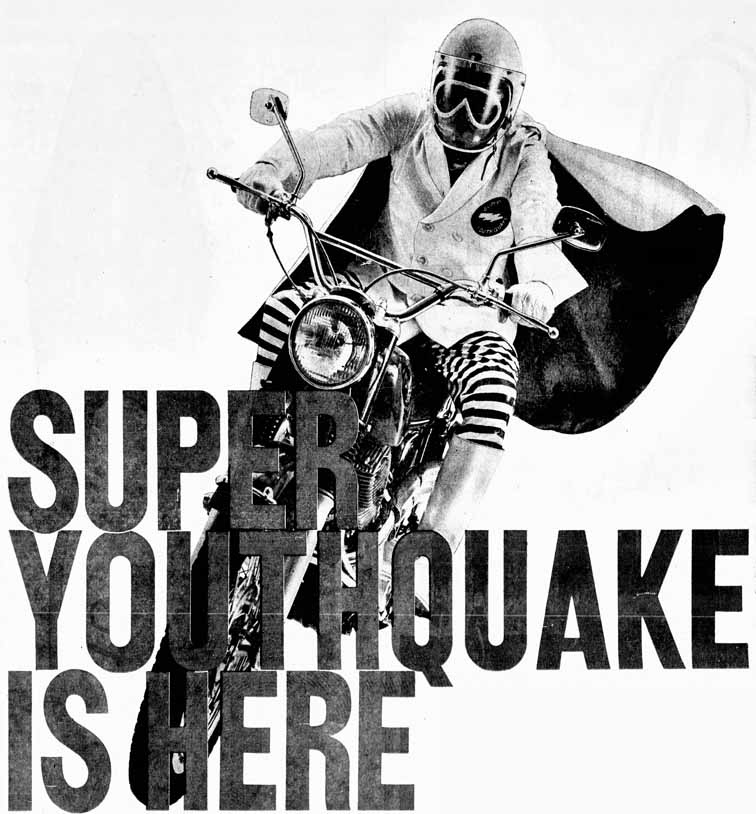
A Calendar of Events in the Strib dated July 31, 1966, described these “Soopah” goings-on:
- Monday, August 1, 1966: Dayton’s Varsity Board and Teen Board arrive. Teen Board members are in brick and heather brown military-look outfits. Super!
- Tuesday, August 2, 1966, 2 pm: Brookdale’s “Soopah” Fashion Show” modeled by the Teen Board and Varsity Board. Music by the Hot 1/2 Dozen.
- Wednesday, August 3, 1966: Southdale’s “Soopah Fashion Show” with stars and time same as Brookdale. Dayton’s Southdale Auditorium, Second Floor. Complimentary Tickets.
SIMON AND GARFUNKEL
Thursday, August 4, 1966: Simon and Garfunkel star at Elite Jr’s fashion show, Kaleidoscope III. Meet Luba, the designer! Hear the Herb Schoenbohm Trio. Shows at 5:30 and 8:00. Paul and Art were spotted at the Triangle Bar that night.
THE YARDBIRDS
Friday, August 5, 1966: “Soopah” Teen Board-Varsity Board show Downtown. Starring THE YARDBIRDS! And the Hot 1/2 Dozen. 8th Floor Auditorium, Downtown Shows at 1 and 3 pm. Although the band had made two other tours in the U.S., this was their first appearance in Minneapolis.
Minneapolis Star
A review in the Minneapolis Star dated August 8, 1966 said that the band lineup at that time was Chris Dreja, Jimmy Page, Keith Relf, Jim McCarty and Jeff Beck. It also said that the members had known each other since grade school, and the word “Yardbirds” was British vernacular for “tramps or hoboes who hitch rides on trains.” Only Jimmy Page could read music; he was the arranger for the group.
Jimmy Page:
The photo below of Jimmy Page of the Yardbirds was taken by John Morris and posted to the Old Minneapolis Facebook page. He is pictured just outside the auditorium on top of the parking ramp between 7th and 8th Streets, just east of Hennepin. The Lumber Exchange Building is over his left shoulder.
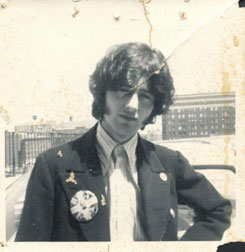
Page was quoted as saying:
This was the first date of any American tour for me, and on this day I played with the Yardbirds on bass. In fact, although having had two visits to the States prior to this, this was the first time I ever played a show there. The first date here in Minneapolis, Minnesota on the 5th of August was at Dayton’s Department Store, 8th Floor Auditorium and the surroundings felt quite surreal.
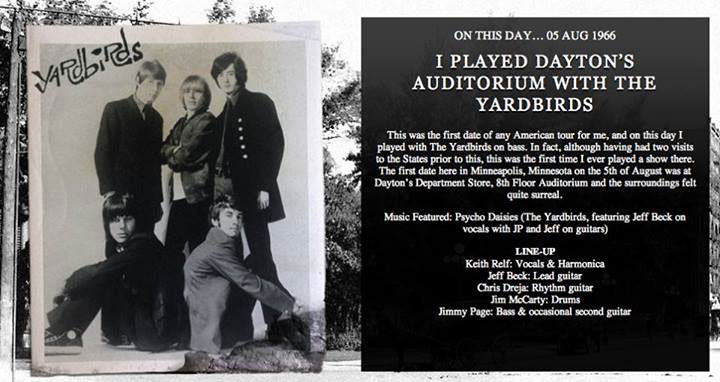
From Jimmy Page’s Web site
Kevin Odegard
This show was extremely influential to many future musicians, including Kevin Odegard, who provided this memoir:
It was a muggy, buggy summer morning at Camp Ajawah, near Wyoming, Minnesota. Little Bobby Rivkin and I rested in our tent following a ritual 20-mile hike the previous day. “There are no shortcuts” was our motto then and now. My mom was on the phone to the camp office to request a visit, which they granted.
Around ten o’clock her familiar green Ford Fairlane pulled in. “Hop in; We’re going to Dayton’s for lunch.” I knew something special was up and we were off to the city. “You like the Yardbirds, right?” “Well yeah; I love that band.” “I got two tickets in the mail from my Oval Room club. Would you like to go?” I gulped at my good fortune and settled in for one more memorable day with my music-loving mom.
Once there, she opted out for retail therapy and I entered the cavernous auditorium alone to the unmistakable sound of of Tom Nystrom doing his very best “Why” in full falsetto. Accents? By the time the Yardbirds hit the stage I was ecstatic having heard most of my local favorites again. I was from small-town rural Minnesota and these “city” bands and the Gestures from Mankato were my own personal Beatles. I even got to know some of them along the way as they passed through my town and the nearby Spectacle Lake Ballroom. In just two weeks I’d see the Liverpool lads themselves at Met Stadium (that’s another story) not to mention the Dave Clark Five in November ‘64 at the Armory.
The first song out of the gate from the newly revamped Yardbirds shook plaster off the walls as bits of acoustic tile rained down on me from the ceiling. “Ain’t Got You” is centered around a shockingly loud bomp! — bomp! kick drum figure. Years later I got a belly laugh out of drummer Jim McCarty when describing that watershed moment in my youth. “Yes. We played loud; indeed we did! Still do; how else you going to get their attention?” Jeff Beck’s ‘diddly diddly doo’ riffs answered the bomps and the show just got better from there; and louder. I noticed there was no Paul Samwell-Smith, so exactly who was that new bass player? Exactly Jimmy Page, that’s who.
I floated out of there on cloud nine to meet mom at the Oak Grill. After lunch we adjourned to the Northbriar Room, newly updated to closely mimic Carnaby Street. The bright flower print shirt and wide-wale corduroys I left with live on in yearbook photos from a class trip.
Back on earth, mom dropped me off at camp with a big smile and bid me farewell with four words I’ve never forgotten. “You’re an expensive date.”
Robb Henry:
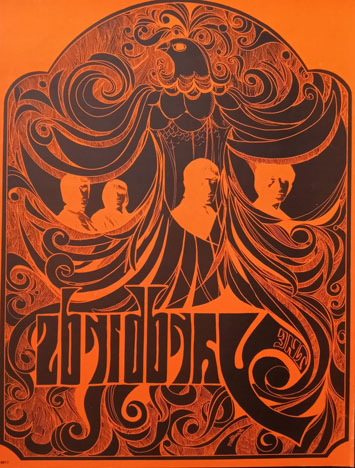
Image courtesy George Ostrushko
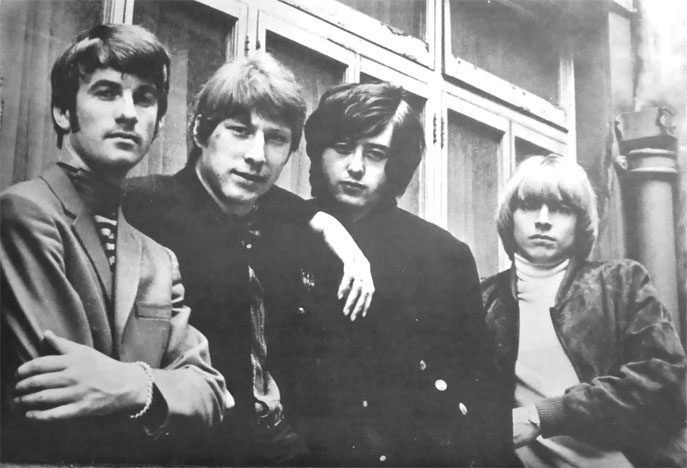
Image courtesy George Ostrushko
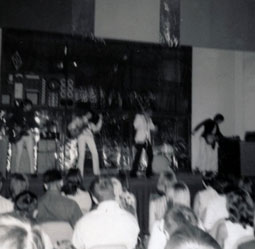
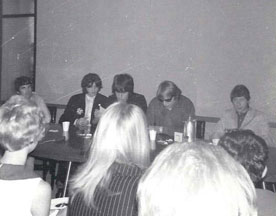
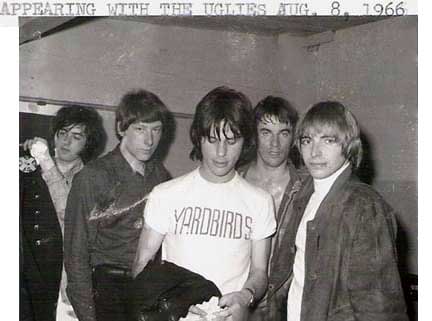
Photo courtesy Robert J. Eveslage of the Uglies
The next night they were down in Iowa at the Roof Garden Ballroom, Arnold’s Park, Lake Okoboji, August 9, 1966.
- Saturday, August 6, 1966: Top Ten radio show broadcast from Dayton’s Downtown Auditorium, 1 to 2 pm. Dance to the Xpressmen! (Bad Omens listed in later ad) from 2 til 3 pm. Complimentary Tickets from Downtown Ticket Office.
- Monday, August 8, 1966: Dayton’s Junior Teen Board is here today. Look for the super JTB in pow plaid hacking jackets and hipster skirts. The THE message for fall.
- Tuesday, August 9, 1966: At Brookdale: “Sound in ’66” … Jr. Teen Teen Board Fashion Show with … The Underbeats! Brookdale Auditorium 2 pm.
- Wednesday, August 10, 1966: At Southdale: “Sound in ’66” Jr. Teen Board Show with the Underbeats. Dayton’s Southdale Auditorium, 2 pm.
- Thursday, August 11, 1966: Roger Nelson arrives with his super London designs. The Xpressmen set the beat. In Grandmother’s Attic, 4th Floor Downtown,12:00 and 2:00
- Friday, August 12, 1966: Downtown: “Sound in ’66 Teen Board Fashion Show. TC Atlantic, the Del Counts, AND Suzie Q and the Originals! 1:30 – 3:30 in Dayton’s Downtown Auditorium, 8th Floor. At Southdale: meet and talk with Roger Nelson in Grandmother’s Attic, 10:30 – 11:30.
- Saturday, August 13, 1966: Top Ten radio show broadcast from the Auditorium Downtown. Fashions, fun dancing, too. The Accents 1:00 to 3:00. Complimentary Tickets from Downtown Ticket Office.
- Monday, August 15, 1966: Seventeen-McCall’s show in Fabrics, 5th Floor Downtown. Mademoiselle back-to-college Beauty Beat! Two hours of fall beauty tricks. Meet Dona Guimaraes, Mlle’s fashion marketing editor; six great looks, super hairdos, the new Miss Ritz cosmetics.
- Tuesday, August 16, 1966: Seventeen-McCall’s fashion show moves on! Dayton’s Fabric department at Southdale and Brookdale.
CHAD MITCHELL TRIO
- Thursday, August 18, 1966: The [Chad] Mitchell Trio, Herb Schoenbohm Trio, and Denise, the California designer! It’s Super ”66 College Board Show time at 5:30 and 8.
- Friday, August 19, 1966: Dayton’s Southdale presents with the Herb Schoenbohm Trio at Dayton’s Southdale Auditorium, no charge.
- Saturday, August 20, 1966: Top Ten features the Chancellors! Super fashions, super sounds. 1 to 3 in Dayton’s Downtown Auditorium. Complimentary Tickets from Downtown Ticket Office.
Dayton’s put on six shows like Youthquake a year, costing $30,000 to $50,000 each. In the August 22, 1966 issue of Newsweek, Dayton’s was named the “swingingest spot in Minneapolis”
1967
On March 4, 1967, Steven Cohen and Peter Nevard, both 24, known collectively as Fantasy Unlimited, produced a “happening” at Dayton’s with the goal of reproducing an LSD trip with lights and music and sounds. Integrated into the show were 20 rolls of photos of images from inside the store. They stood on top of two towers with about 15 slide projectors each and a couple dozen light switches. A rock band played below. The pair were graduates of Carnegie Tech and came from New York where they had done similar shows for fashion shows. The dream was to build a walk-in psychedelic kaleidoscope nine feet tall, completely lined with mirrors. The 12,000 sq. ft. auditorium was transformed into an “environmental envelope” where dancers were “showered with 1,000 shattered images of light.” In her column explaining all of this, Barbara Flanagan commented “I wondered if all of the sights, sounds and possibly smells might not make one nauseated. Should teens with tipsy stomachs stoke up on Dramamine before showing up tomorrow?” “It could happen, of course, said Cohen. “But it never has,” said Nevard. Similar shows were planned for May 20 and June 17, 1967.
TWIGGY
Twiggy made a trip to the U.S. in 1967, making only three stops: New York, Hollywood, and our own Dayton’s on April 23. When she arrived at the airport she was met with about 300 teenage girls and eight Minneapolis girls made up to look like emaciated fashion models, holding silver “Welcome Twiggy” signs.
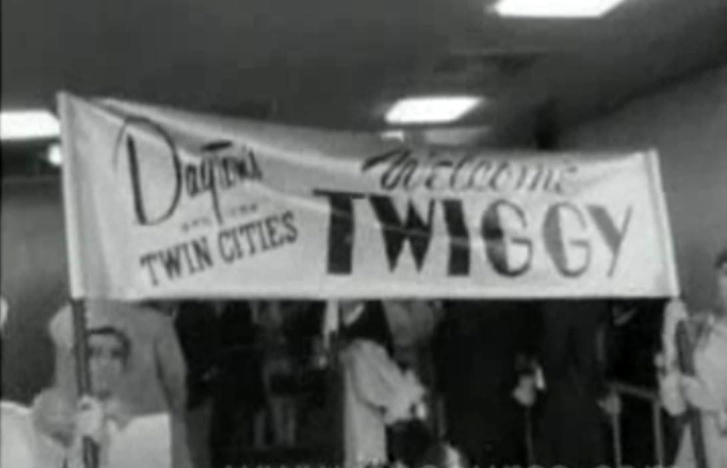
Photo copyright Mike Barich
1,500 teenage girls came to the 8th floor auditorium to see her; one fan who attended the show reports that the girls got free Yardley lipsticks.
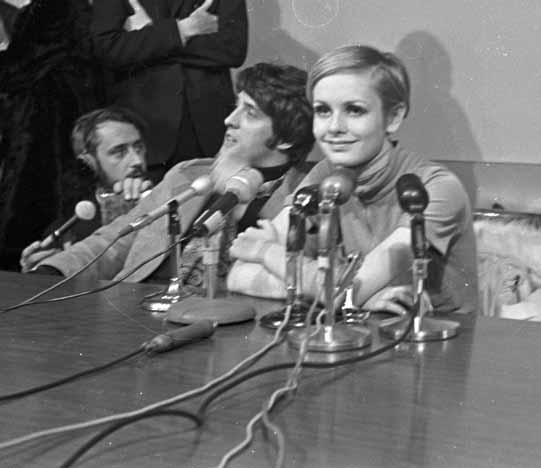
Press Conference. Photo copyright Mike Barich
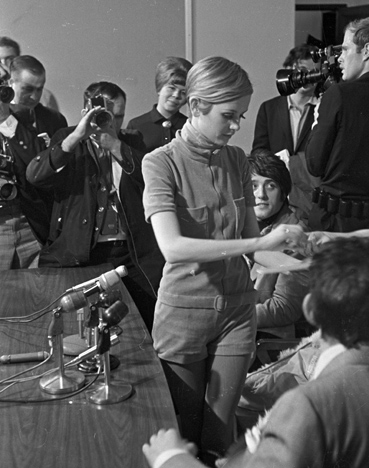
Twiggy’s outfit. Photo copyright Mike Barich
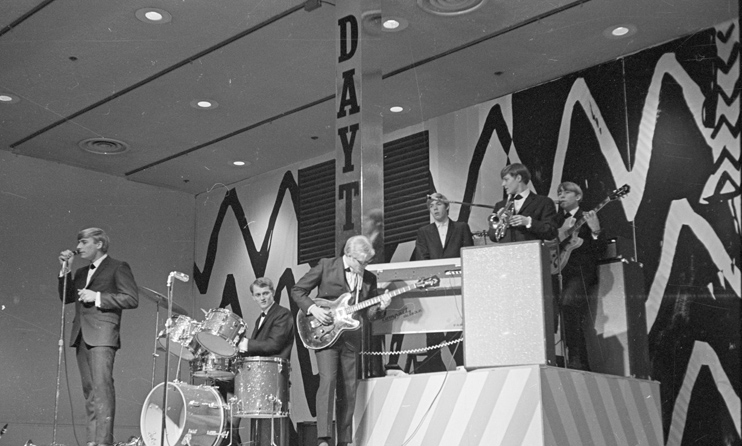
The Hot Half Dozen played at the event. Photo copyright Mike Barich.
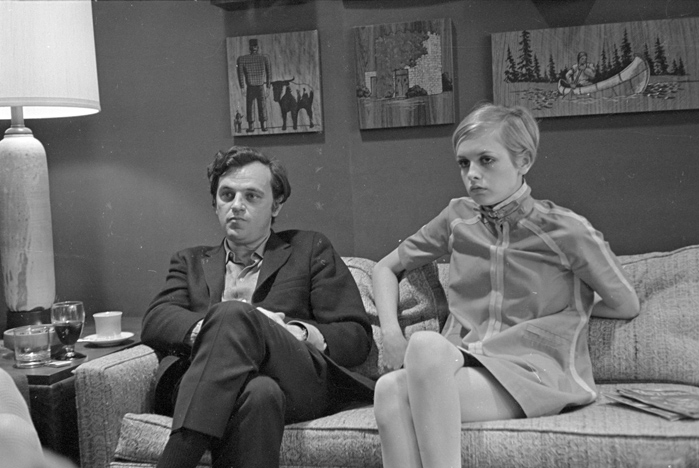
Relaxing after the appearance? Photo copyright Mike Barich
PAUL BUTTERFIELD BLUES BAND
On May 20, 1967, Dayton’s Department Store sponsored a second “Sensations ’67 – Trip II” show. Local heroes the High Spirits appeared with the Paul Butterfield Blues Band (which included Elvin Bishop on guitar and Mark Naftalin – son of Mpls. Mayor Naftalin – on keyboards). Music Scene promised that the psychedelic show would transform Dayton’s 8th Floor Auditorium into an “‘environmental envelope’ of another time, space, and place” – all for $1.50! Shows were at 12, 2, and 4. The radio commercial urged the kids to get their tickets soon, as “Last time thousands were turned away!” A third Sensations was scheduled for June 17, 1967. (Did that happen?).
In August 1967, Dayton’s initiated an experimental film series in its 8th Floor Auditorium, some with what Will Jones described as “rock-and-light overtones.” Jordan Belson’s “Allures” was described in the program notes as “a hallucinogenic voyage into the distance of outer space [that] suggests an emotional significance like that of music, the subliminal rhythms of the inner cosmos.” It reminded Jones of the time he was given ether for a tonsillectomy.
THE ASSOCIATION, SPANKY AND OUR GANG
Dayton’s 8th Floor Auditorium hosted the Association and Spanky and Our Gang on August 17, 1967.
On October 23, 1967, KDWB and Dayton’s sponsored a High School pep fest at the bandstand at Lake Harriet. Ron Block was the emcee for the event that attracted 2,000 students, cheerleaders, football players and homecoming queens from 30 schools. The Dayton’s Teen Council put on a fashion show. Robbinsdale won $100 for having the biggest turnout, which was earmarked for their American Field Service fund.
DIONNE WARWICK
Dionne Warwick appeared at the Dayton’s Skyroom for two shows on November 20, 1967. Rollie Anderson remembers:
For some reason in November of 1967, Dayton’s sponsored an intimate performance by Dionne Warwick in their Sky Room restaurant area. It really didn’t hold that many people, so we felt pretty special and lucky to get tickets. The performance was announced and the tickets went on sale just five days before the show. I called Dayton’s over 20 times with continuous busy signals before I finally got through. There’s really not that much to my story but here it goes: (from his diary:)
Dionne Warwick performance at Dayton’s is tremendous!
11.22.1967
As planned tonight, Mom, Marilyn, Shari & I all left for downtown at 8:00 for the Dionne Warwick show at Dayton’s Sky Room. When at Dayton’s, Mom felt sort of out of place because it was almost all young people, but she loved the show. Dionne was tremendous. She sang all her greats – Don’t Make Me Over, Walk on By, Reach Out for Me, Anyone Who had a Heart, You’ll Never Get to Heaven, etc.. etc.
Please see the Blue Horse.
The Hotel Del Otero was located at what is now 4050 Shoreline Drive in Spring Park, at Lake Minnetonka. The location was 18 miles from Minneapolis.
In the days before air conditioning, it was common for city folk to escape to the cool breezes of Lake Minnetonka for extended stays at large hotels like the Del Otero. The newspapers were full of announcements that prominent families were summering at the hotel, fishing and partaking of other summer fun.
See the bottom of this page for the Spring Park Casino
Some information on this page came from an article by Ton LaVoie published in by the Sun Patriot on August 3, 2012, called “Lake Minnetonka History: A look at the Del Otero Hotel”
HOTEL
The hotel itself underwent expansions over the years, and the capacity numbers changed considerably as reported in news articles. The postcard below shows the hotel, probably as originally built.
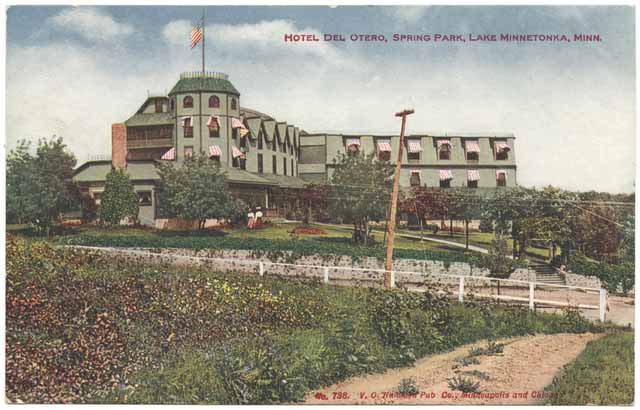
Hotel Otero, 1908. Image courtesy Minnesota Historical Society
The photo below appears to show an addition on the left side. A large extension had been added to the hotel in 1901.
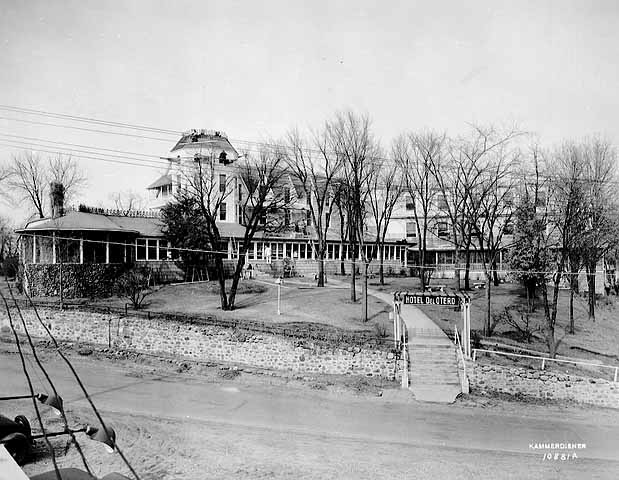
View from the street, 1925. Photo courtesy Minnesota Historical Society
The cruise boats and streetcar boats visited the hotel docks.
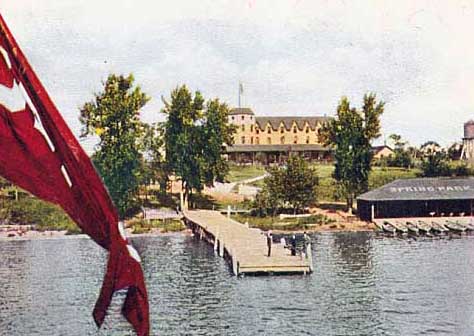
The Del Otero’s dock, 1906. Photo courtesy Minnesota Historical Society
DINING
Guests and visitors came to the hotel by boat to dine in the hotel’s two large dining rooms. Many companies and associations had their annual banquets in these dining rooms.
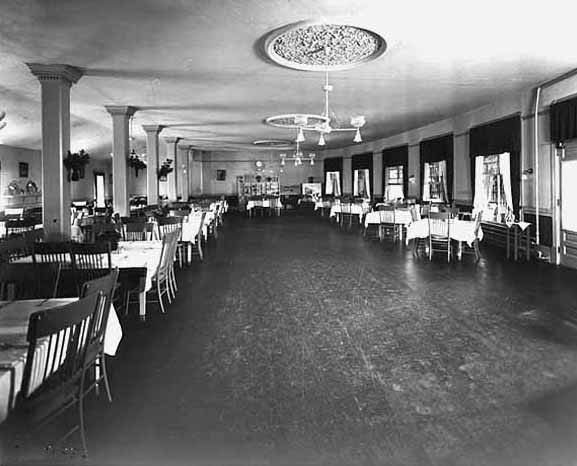
Del Otero Dining Room, 1921. Photo courtesy Minnesota Historical Society
CHRONOLOGY OF THE DEL OTERO
The Del Otero was the second large hotel built by James J. Hill as a destination resort for his Great Northern railroad, designed to bring tourists and visitors to Lake Minnetonka. (The word “Otero” is Spanish for Hill.)
It was completed in May 1892, on the shore of the Spring Park Bay boat launch. [Although the date 1885 is often used, it is clearly stated in the first listing in the newspapers.com database that it is “a hew hotel, just completed.” (Minneapolis Tribune, May 29, 1892)] The hotel faced Spring Park Bay and had window rooms to take in the view from all around the area.
The first owner/manager was G.F. Hopkins. Since the hotel was only open during the summer, Hopkins and his wife wintered in California, where he also owned Rancho Del Otero, near San Diego.
In the 1904 season it was SRO, with guests sleeping on cots, in tents, and doubled up in rooms. The main draw was said to be Professor Sutorious providing musical treats for one and all. (Minneapolis Journal, August 15, 1904)
In June 1920, Adam F. King purchased the hotel. King had been the proprietor of a large hotel in Syracuse, New York, for 20 years. The announcement revealed that the hotel could accommodate 300 guests. The hotel was redecorated, and additional cottages were built. There was dancing daily, with the the Stewart’s Orchestra as the house band. (Minneapolis Tribune, June 6, 1920)
The hotel’s advertising was minimal at best, and usually placed on travel pages of the newspaper. The one below at least had some information about the place.
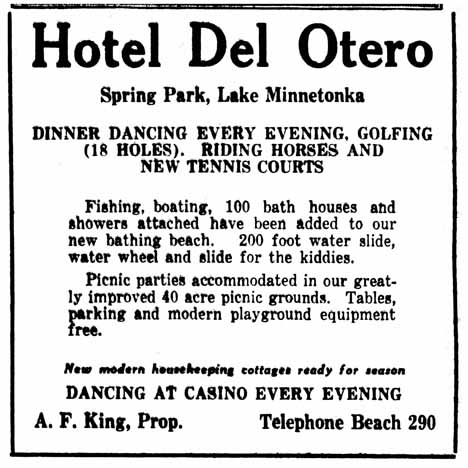
Minneapolis Tribune, June 16, 1929
In April 1938, King purchased the rest of the rest of the 40-acre property, including the Casino (see below) and picnic grounds. The Tribune reported that it was the first change of ownership of this land since the establishment of the hotel by James J. Hill. The article said that the hotel’s capacity was 85 guest rooms, with nine cottages. (Tribune, May 1, 1938)
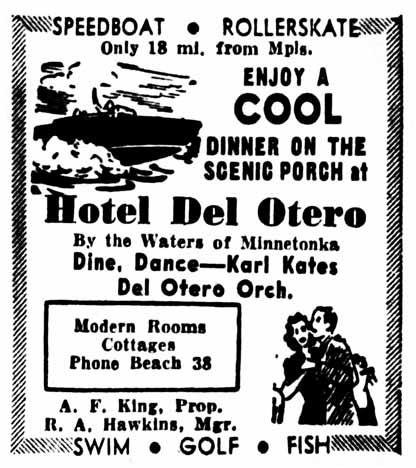
Minneapolis Star, August 2, 1942
Classified ads show that help was difficult to find during the War years. Business must have been off, as room and board were offered to applicants. Rubber rationing made it difficult for city residents to drive to the Lake, although they could still take the bus or train.
THE END OF THE DEL OTERO
After 60 years, the Hotel Del Otero was gone in one night. On the evening of July 16, 1945, a gathering of military officers and guests were enjoying accommodations at the hotel. Around 3:25 a.m., fire broke out.
With the hotel’s position, the windy conditions of the lake, and the building’s three-story height, the fire was unstoppable. One section, a two-story towering structure built in rococo style surrounded by wide porches, burned completely to the ground. The remaining section burned to the first floor. The blaze was thought to have started in the kitchen. None of the guest cottages, mostly occupied by employees, were damaged. The account said that the hotel had 50 guest rooms.
43 people, most of them guests, fled the burning building with nothing but their nightclothes on their backs. Owner/Manager King carried his invalid brother to safety. A bellboy suffered a slight arm injury when he swung himself from a window in his tower bedroom to a porch roof. Many others made it to porch roofs as well and were rescued by firemen from Wayzata, Mound, and Excelsior. As the guests were rescued and firemen retrieved such belongings as they could, many of them got in their cars and drove home to Minneapolis. For others, the former Casino, now used as a war plant, was used as a place of refuge. Residents of Spring Park provided coffee and sandwiches.
King spoke of wanting to move the hotel to a vacant facility in order to honor existing contracts.
THE SPRING PARK CASINO
DANCING PAVILION
The original dancing pavilion was used for regularly scheduled dances (first known as “hops”), with music provided by bands. The floor, made of Georgia pine, was put in in 1901, and measured 50′ by 150′.
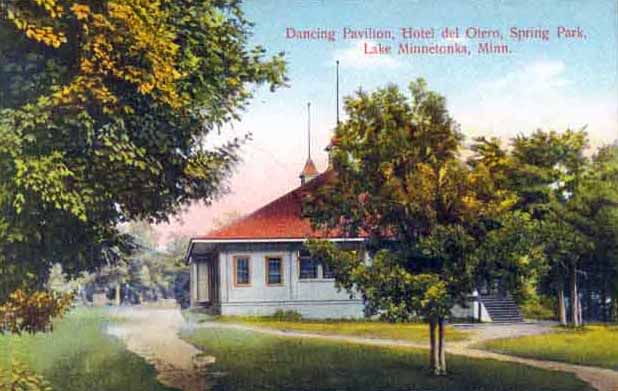
Del Otero Dancing Pavilion. Image courtesy Minnesota Historical Society
On August 24, 1902, the dancing pavilion was totally destroyed by fire. The building also housed a restaurant, boathouse, bowling alley, and a fleet of row boats underneath. The loss was estimated at $3,000, and the hotel carried no insurance. (Minneapolis Journal, August 25, 1902)
THE SPRING PARK CASINO
In the spring of 1903, it was reported that hotel owner G.F. Hopkins would build a new pavilion, called “The Casino,” to replace the one that burned. This one measured 48′ by 112′. The word Casino in those days did not mean a gambling casino, but a place for dancing and other recreation and entertainment.
Like the Dancing Pavilion, the Casino had a three-lane bowling alley, a cafe, and a boathouse in the basement stocked with rowboats for rental. The place was finished in “Flemish Oak.” It was considered an adjunct to the hotel, and was situated “across the highway” from the Del Otero. (Minneapolis Journal, June 13, 1903)
In 1905 and for several years, “hops” were given every Friday. It was announced that the Casino would be given a Mexican name, to match the other buildings at the Del Otero. Evidence of such a name could not be found. (Minneapolis Journal, July 20, 1905)
In 1931 the house band was the Admirals.
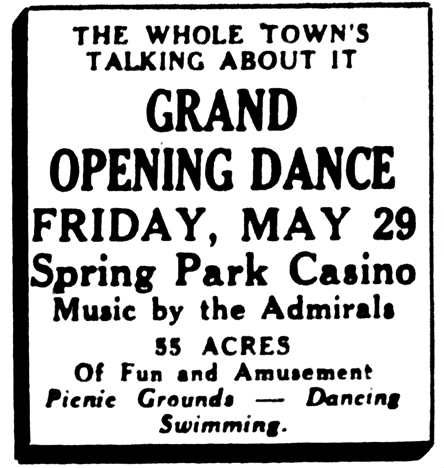
Minneapolis Tribune, May 1931
In 1933 it was the Hotel Del Otero Orchestra.
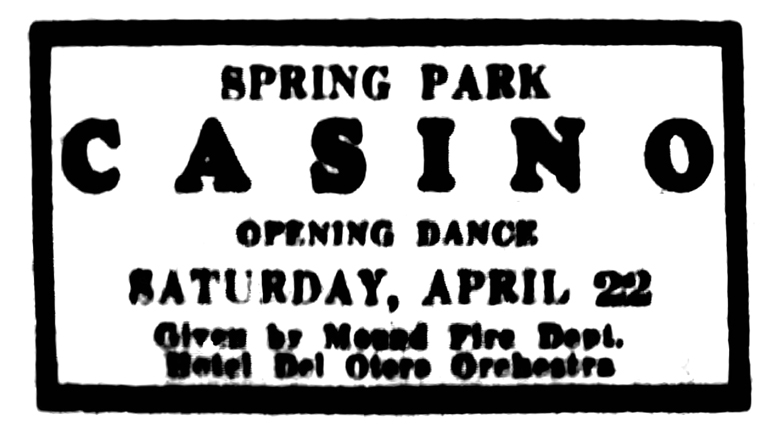
Minneapolis Tribune, April 21, 1933
In April 1938, hotel owner A.F. King purchased the rest of the rest of the 40-acre property, including the Casino and picnic grounds. The Tribune reported that it was the first change of ownership of this land since the establishment of the hotel by James J. Hill. (Tribune, May 1, 1938)
In 1942, the Casino added a roller skating rink and amusement rides, including a Ferris wheel and merry-go-round. (Minneapolis Star, April 26, 1942)
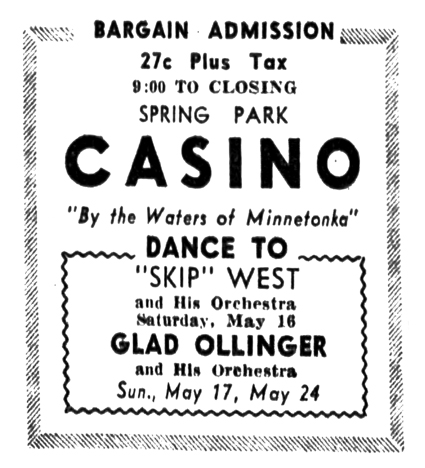
Minneapolis Star, May 15, 1942
As the War dragged on, the Casino was leased to the L.E. Streator Lumber Co. for storage of ammunition boxes that it was manufacturing on contract for the government. The lumber company purchased the building in April 1944. (Minneapolis Star, April 25, 1944)
After the War the Casino had been turned into a new plastics plant by Streator. It was destroyed by fire on November 1, 1945. (Minneapolis Star-Journal, November 1, 1945)
In 1947 there was an article in the Star about plans to salvage part of the building, and that the beach area was now owned by the County. (Minneapolis Star, July 28, 1947)
The Delmonico Nite Club was located on New Brighton Road and County Road E in July-December 1943. Open Saturdays and Sundays.
University Ave. Started featuring rock on Mondays and Tuesdays in 1973. Same as Denny’s Loft, on University across from the Prom?
Denny’s was at 33 1/2 South 7th Street in Minneapolis, across from the Forum Cafeteria. It opened and closed in 1934 but during its short life it featured floor shows and dancing, and Joe Jung playing jazz violin.
Denny’s Loft was located at 1183 University Ave. in St. Paul, across from the Prom Ballroom.
It was one of several bars owned by Ron Maddox, who had abandoned a successful insurance business to open the bar in March 1970. It was a country bar – the house band was the Hanging Tree, with frontman Danny Hargrove. Music from the bar was simulcast on Wednesday evenings on WMIN-AM radio. It was a hangout for cops, they say on Facebook.
The venue first shows up in the paper in March 1970.
In 1973 it followed the trend, with exotic dancers at lunch.
In August 1977, Steven Billings was identified as the owner.
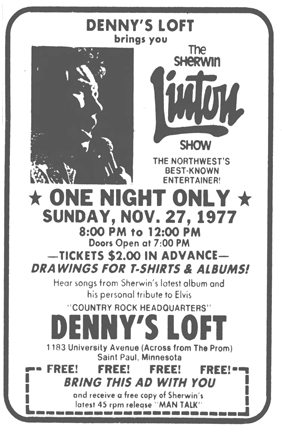
In 1982 the bar featured Singles dances, with dance lessons by Dean Constantine.
The last mention was on September 4, 1982.
Please see Shaw’s.
The 1948 ads below describe the location of the Depot Nite Club as North Lexington Ave. at Lake Josephine, just north of the St. Paul City limits. The 1955 ad provides the address 3092 N. Lexington, in Roseville.
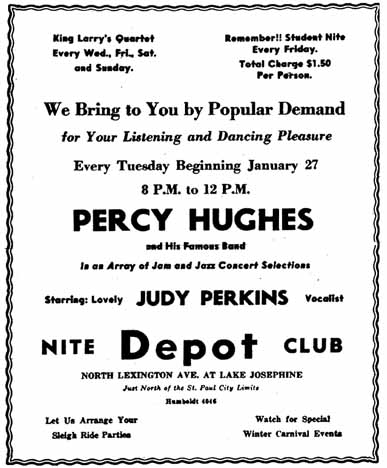
Minnesota Daily, January 23, 1948. Ad courtesy Robb Henry
One of the artists who performed at the Depot Nite Club was Prince Rogers, with his band and vocalist Ginny Robins. Prince Rogers was the stage name of John L. Nelson, and was the father of Prince Rogers Nelson.
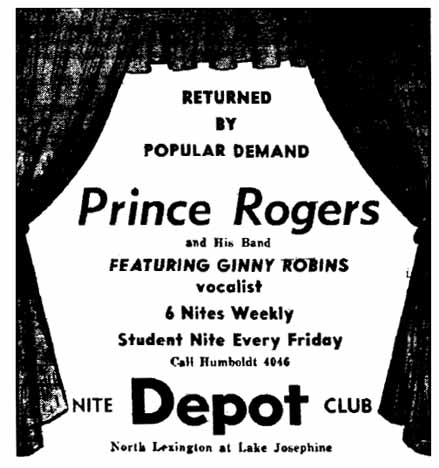
Minnesota Daily, May 7, 1948. Ad courtesy Robb Henry
The photo below is not necessarily from this venue, but is of Prince Rogers and His Trio, with Rogers at the piano.
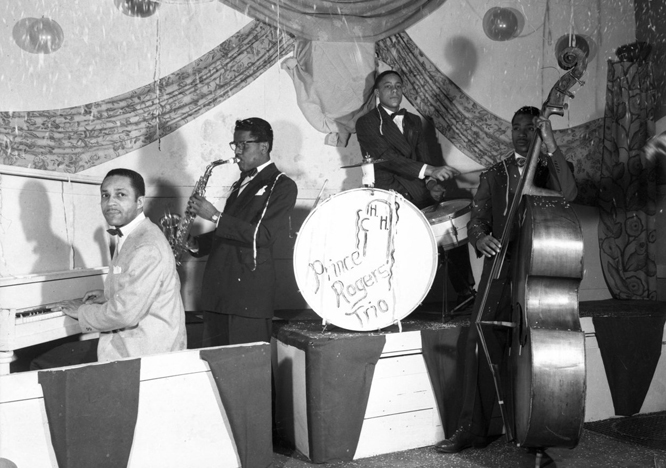
Photo by John Glanton, courtesy Hennepin County Library
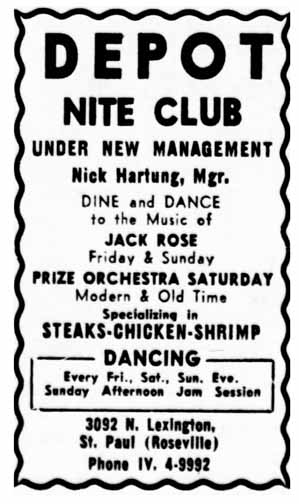
Minneapolis Star, August 13, 1955
The Depot Nite Club was being turned into a teen club by owner John Gospeter in July 1956. It had lost its beer license in June 1956.Tommy Dooher’s rock ‘n’ roll band would perform. In 1958 Gospeter owned the River Road Club.
The building is still on Google! Here’s a screenshot:
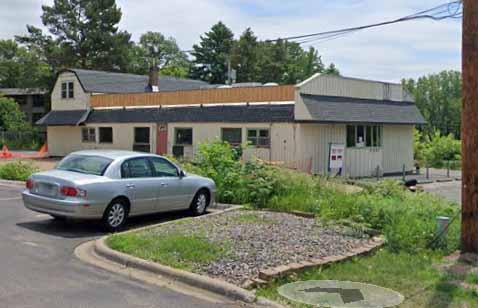
This page is about the legendary clubs that have been located at the corner of Seventh Street No. and First Ave. No. in Minneapolis.
I. INTRODUCTION
First I’ll lay out some things to take into consideration when reading this page, introduce the founders of the Depot, and direct you to my sources.
II. THE MUSIC
Next is the story of the music and other goings-on at the Depot, Uncle Sam’s, and Sam’s, with ads, posters, photos, tickets, show reviews, etc.
III. BEFORE THE MUSIC
This section looks at the history of the site, going back to its first uses – as a grade school, believe it or not – an office building/bus station, and of course the City’s Greyhound bus depot. This is undoubtedly more than you’ll ever want to know, but this is called going down the rabbit hole…
IV. HISTORY OF THE COMMITTEE, INC.
The last section focuses on the history of the organization that started the Depot and owned each club until First Avenue’s bankruptcy in 2004. This includes the people who turned an old bus terminal into the hippest place in town, and the machinations that happened along the way.
I. INTRODUCTION
NOTES
As a rule, this entire website focuses on Twin Cities music through 1974 but I’ve made a slight exception here. This page will cover the Depot, which began in 1970; Uncle Sam’s, which began in 1972; and Sam’s, which began in 1980. 7th Street Entry (March 21, 1980) and First Avenue (January 1, 1982) will not be covered here, except for information on the Committee in Section IV.
About the address: during the bus station, Depot, and Uncle Sam’s days, the address of the building was given as 29 Seventh Street No. At some point it reverted to its actual address of 701 First Ave. No. How the other address came into play is a question to be answered.
A bit of trivia: First Avenue was originally called Utah Avenue.
And just so I don’t have to keep repeating it, Will Jones was the wonderful entertainment columnist for the Minneapolis Tribune. Yes, he was a little old to appreciate rock venues, and those “girl watching” features wouldn’t pass the muster today, but his columns held a wealth of information about popular culture and what was going on around Minneapolis. Thank goodness for Will Jones!
THE FOUNDERS
The following are thumbnail sketches of the four original members of The Committee, the organization that created the Depot.
DANNY STEVENS
Danny Stevens was always very athletic, participating in water skiing and Golden Gloves Boxing from ages 10 to 17. He graduated from West High School in 1961, and studied pre-med at the University of Minnesota. In 1964 his first band, Danny and the Nightsounds, won the Battle of the Bands at the 1964 Teen Fair at the State Fair. Later that year he started Danny’s Reasons, a tremendously successful band that would last for decades and include many different members along the way. Danny’s Reasons played in dozens of local clubs in the area. The band was inducted into the Mid-America Music Hall of Fame in 2007.
Statements made by or information received from Danny are marked (DS)
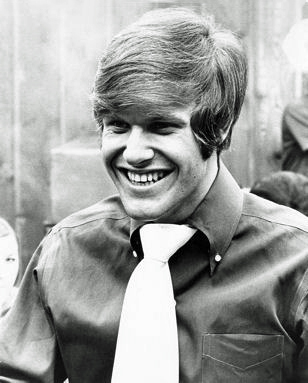
Photo courtesy Danny Stevens
ALLAN FINGERHUT
Allan was the son of Manny Fingerhut, who had founded Fingerhut Manufacturing Co., a company that started out making seat covers for cars. The Fingerhut catalog empire created innovative ways for people to buy goods on time and with a special Fingerhut credit card. This made Manny a millionaire. Allan was one of Manny and Rose’s three children. He was born in 1944 and graduated from St. Louis Park High School in 1962. After high school he attended the New York School of Design, and served in the Army.
Thanks to the efforts of David Roth and Allan’s daughter Rain, I was able to have an extensive telephone conversation with Allan and his wife Rose. Although he was already suffering from the effects of Lewy Bodies Dementia, which made it difficult to remember some things, he did remember many people and was interested to know what had become of them. I am very grateful for the opportunity to have talked with him. Statements made by or information received from Allan are marked (AF). Allan passed away on October 12, 2020, and was interred at Lakewood Cemetery, Minneapolis.
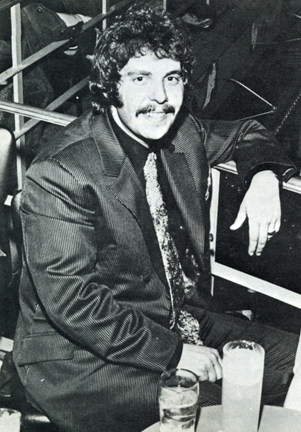
Allan Fingerhut. Photo copyright Mike Barich, St. Paul
SHARRON FINGERHUT
Sharron was married to Allan from 1965 to 1974, and they had two children. Sharron served as the Secretary and/or Treasurer of The Committee from 1970 to 1976. Her last name is now Grohoski.
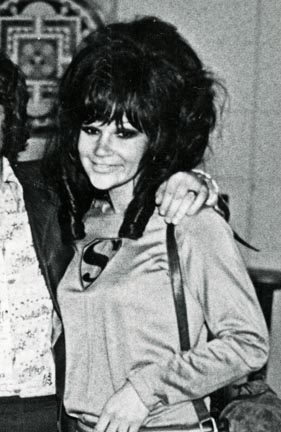
Photo courtesy Sharron Grohoski.
ABBY ROSENTHAL
Abbott “Abby” Rosenthal graduated from St. Louis Park High School High School in 1959. He was tapped to be the first General Manager of the Depot because he had filled the same job at George’s in the Park in St. Louis Park. Abby was not with the Depot for very long. He was an artist when he died in 2016.
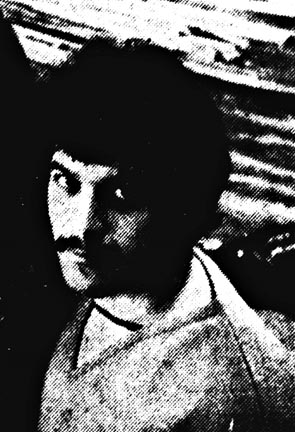
Minneapolis Tribune, February 22, 1970
I went ’round and ’round about where to put my sources. I have made a special effort to credit each source I’ve used, and there are a lot of them. The list is identified by abbreviations that are used throughout this page, so you might want to refer to them as you read. So I decided to put them on a separate page so you can toggle between them instead of scrolling up and down. I hope that is useful. If not, please let me know.
II. THE MUSIC
In this section I will try to list as many of the shows presented at the Depot, Uncle Sam’s, and Sam’s as I’ve been able to find, augmented with reviews, photos, posters, and anything else floating around. I’m sure there were many more shows to find. Ads are from the Minneapolis Star and Tribune unless otherwise attributed. Please note that the synopses of the reviews are my interpretations of longer articles. If you have any photos or stories to share, and by all means if you have any corrections, please contact me!
EARLY PRESS
January 10, 1970, Connie’s Insider: Connie Hechter was the editor of Connie’s Insider, a music magazine that started in 1967 and ran until Connie’s death in 1978.
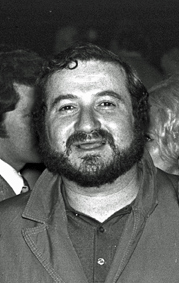
Photo of Connie Hechter – copyright Mike Barich, St. Paul
Connie got the jump on the first press announcement of the new club, even before the application for the liquor license was submitted:
Danny Stevens and Abby Rosenthal will team together (Rosenthal formerly was with the management at George’s in the Park) to open the defunct, or vacated Bus Depot….the old one. It will make a great club and is an outstanding downtown Minneapolis location, if Ted Mann doesn’t build a theatre on the property in the near future. He owns the land, so I’m told. He also owns most of the show houses downtown.
February 7, 1970, Connie’s Insider: “Oh yes, the new club that Danny Stevens and Abby Rosenthal will open in April is also co-owned by Allan Fingerhut. I forgot to mention that in the last issue. In fact, if it wasn’t for Mr. Fingerhut, there would be no Depot.”
HELP WANTED AND MORE PRESS
On February 20, 1970, this ad appeared in the Minneapolis Star. It was a different time, folks.

February 22, 1970, Minneapolis Tribune: An article by Allan Holbert was called “Shops, Night Club to Open.” Interesting that he listed the shops first.
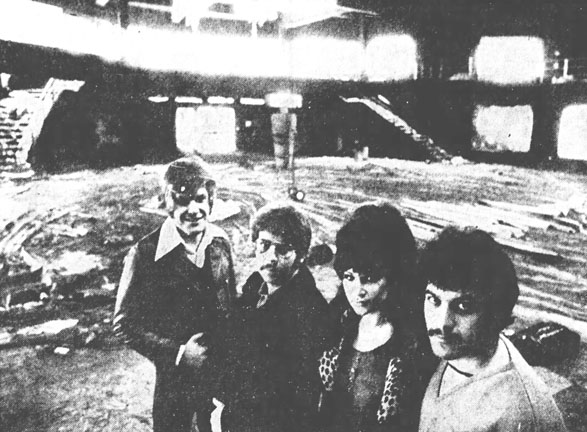
Minneapolis Tribune, February 22, 1970. Photo by Earl Seubert
Original caption: Danny Stevens, left; Allan and Sharron Fingerhut; Abbott Rosenthal
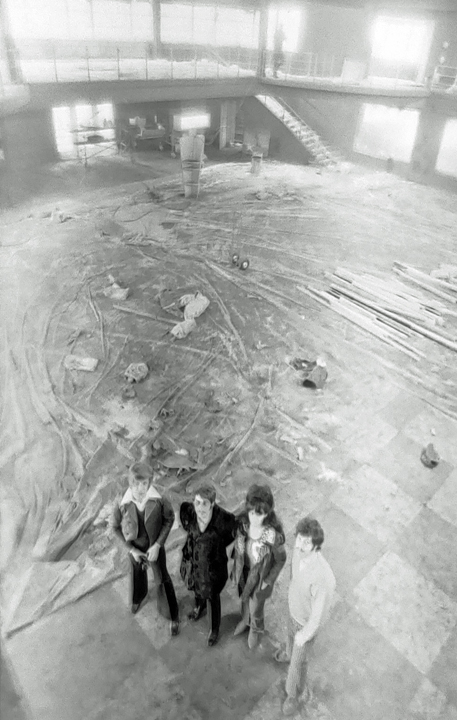
The Committee in the empty depot. Photo courtesy David Roth
Holbert:
Management
Owner of the Depot is a new corporation called the Committee. Allan Fingerhut, whose family is a major owner of the Fingerhut Manufacturing Corp., is chairman of the board. Danny Stevens, head of Danny’s Reasons rock band, is president.
Managing the 40 or so employees will be Abby Rosenthal, former manager of George’s in the Park.
With regard to the shops, the article gave out with some very ambitious plans, which didn’t materialize:
- Two clothing stores:
- I, Ross
- East-West Ltd.
- A Record shop
- A Novelty shop
- Three bars (there were eventually at least five). One of the bars, The Second Floor of the World, “will have low-priced drinks and is expected to attract some of the 5 o’clock trade of young working people who now frequent such places as Buster’s and Duff’s.”
Holbert noted that the venue would be opened by Joe Cocker on April 3 and 4, 1970, (which it was), but also listed other bookings of the Vanilla Fudge for April 10 and 11 and Janis Joplin for April 18 and 19 – neither shows eventually panned out.
February 24, 1970 – Minneapolis Star Allan is quoted as saying the acoustics in the building were perfect – “despite the memories of some past bus riders of unintelligible public address calls there.” The new corporation was called The Committee, with Fingerhut acting as chairman of the board and Stevens as president.
February 28, 1970, Connie’s Insider: “Joe Cocker is booked for the opening weekend of the Depot in Minneapolis, scheduled for April 3rd, I believe. This club has got everything going for it. Admission for the Cocker opening will be $3. You have to be 21 to make the scene at the Depot. By the way, Danny Stevens assures me that the Depot will go out of its way to play new, upcoming bands, in addition to the best in local talent.”
March 21, 1970, Connie’s Insider
The Committee advertised heavily in Connie’s Insider before its first show, but not very much thereafter.
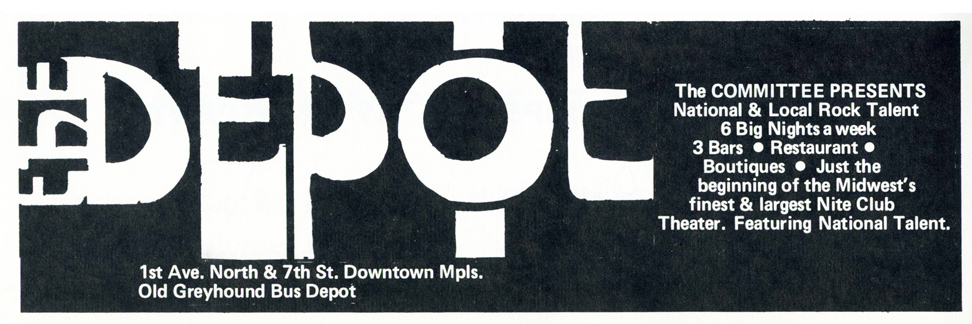
Page 30: THE COMMITTEE PRESENTS National & Local Rock Talent 6 Big Nights a week. 3 Bars; Restaurant; Boutiques; Just the beginning of the Midwest’s finest and largest Nite Club Theater. Featuring National Talent.
Page 32: HAPPINESS IS A GUY NAMED JOE! FOLLOW THE SEARCHLIGHTS APRIL 3 FOR A NICE TRIP! (Old Greyhound Depot) Downtown Minneapolis
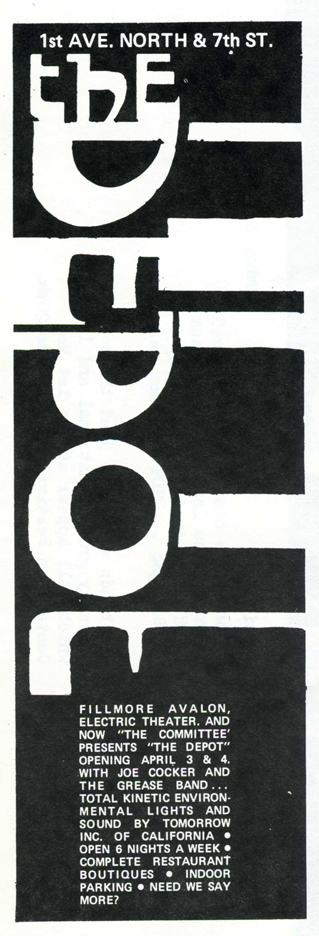
Page 35: Fillmore Avalon, Electric Theater, and now “The Committee” Presents “The Depot,” Opening April 3 & 4 with Joe Cocker and the Grease Band … Total Kinetic Environmental Lights and Sound by Tomorrow Inc. of California * Open 6 Nights a Week * Complete Restaurant * Boutiques * Indoor Parking * Need We Say More?
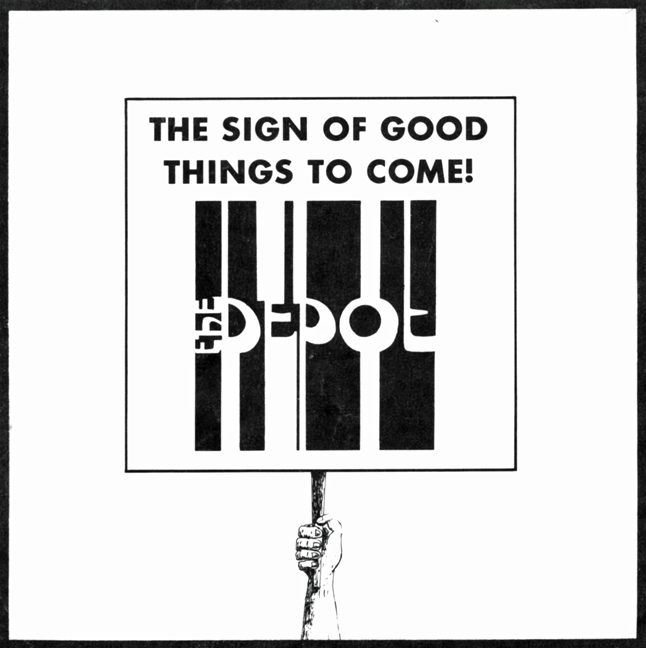
March 29, 1970, Minneapolis Tribune: “A Short Wait at The Depot”
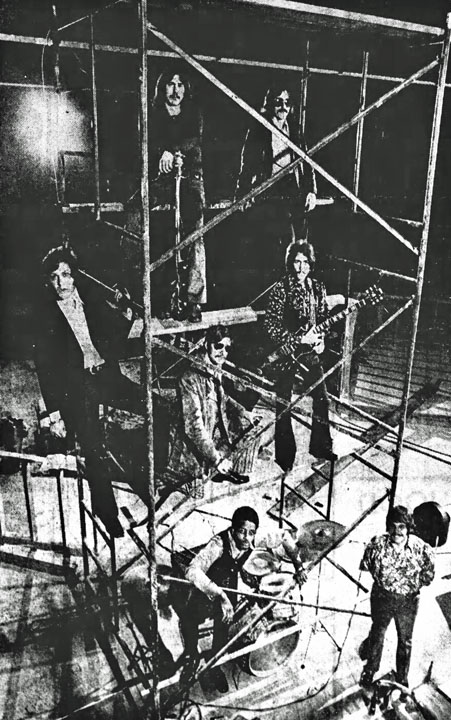
Minneapolis Tribune, March 29, 1970. Photo by Mike Zerby
Danny Stevens, hanging in there on the left side of the scaffold, and his band, The Reasons, posed last week in the former Greyhound Bus Terminal, 7th St. and 1st Av. N., which is due to open Friday as a night club called The Depot. Stevens, president of the corporation that owns the operation, and the others appeared confident that redecorating will be completed in time.
THE SAGA OF HARVEY DUBISCH
In an attempt to create a buzz about the Depot, Allan got it in his head to put up 30 billboards around town that said something to the effect that “Everyone is Invited to the Depot… Except Harvey Dubisch.” Those stayed up for about three months. As a follow-up, for a month he put up the billboards shown below, ostensibly an answer from the supposedly fictional Harvey Dubisch, demanding to be invited to the Depot.
The campaign created enough of a stir to be included in Minneapolis Star columnist Abe Altrowitz’s “View From Lake Calhoun” column on May 21, 1970. Altrowitz was enamored of a new acronym, Deleted On Grounds Of National Security (DOGONS), and named several instances where he could use it. One of them was, “The real reason Harvey Dubish is barred from The Depot is — DOGONS.”
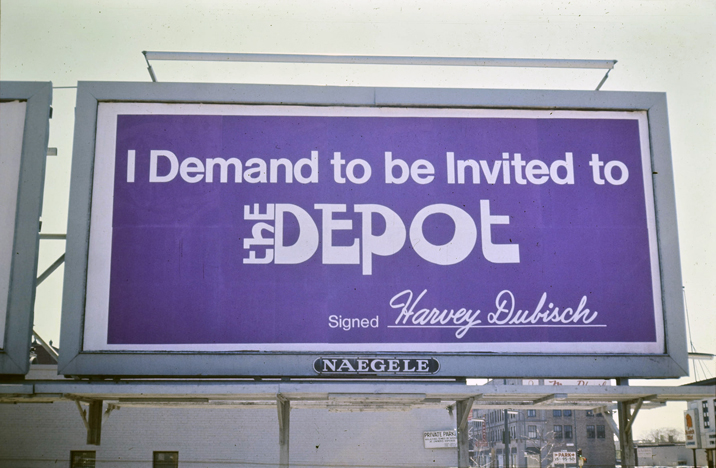
Image courtesy Hennepin County Library
Well, the problem was that Allan neglected to check to see if there was a real Harvey Dubisch who might take issue with having his name bandied about on billboards. Close enough – there was a Harvey Dubish who owned an iron and metal company in St. Louis Park – Allan’s home town. And Mr. Dubish was not amused. In fact, Allan told me that his wife sued, and the Committee had to dig into their limited funds even further to take care of that fiasco.
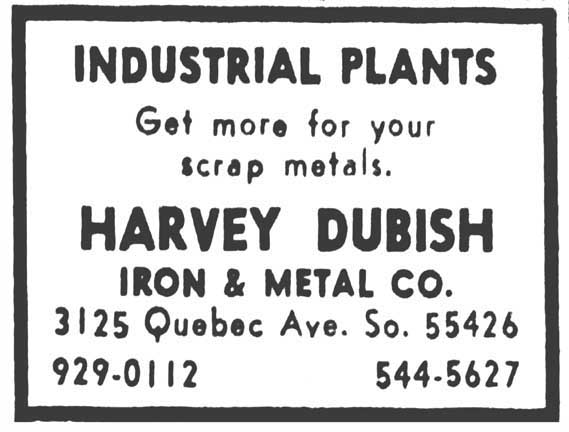
Minneapolis Tribune, November 8, 1970
INTERIOR OF THE DEPOT
The interior was designed by John Neil, with many of the walls decorated with huge pop murals done by West Bank painters. The decor was purple, with purple shag carpet on the stage. The purple was in honor of the Minnesota Vikings, who had come to town nine years earlier.
The Depot was still being hammered and sawed up to the last minute. Here’s a bird’s eye view of what it looked like in the very early days.
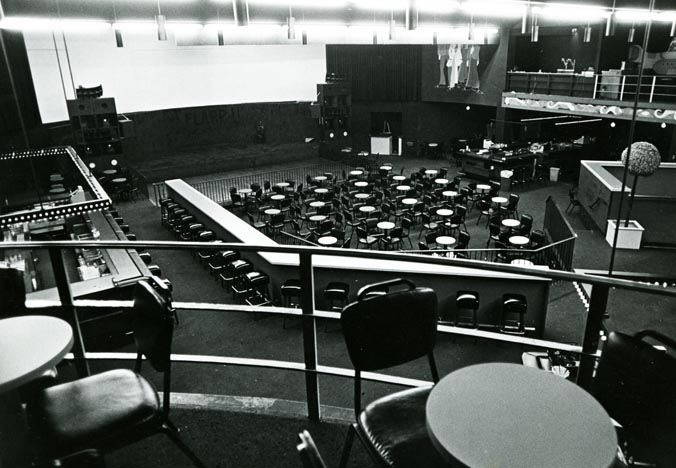
Photo courtesy Sharron Grohoski. From First Avenue: Minnesota’s Mainroom by Chris Riemenschneider, MNHS Press, 2017
There was at least one large picture of the Beatles on the wall – the closest photo found is this one from the Ramsey Lewis show, where part of one is seen up on the balcony. Perhaps a foreshadowing of the John Lennon Tributes that take place each year on December 8, led by Curtiss A.
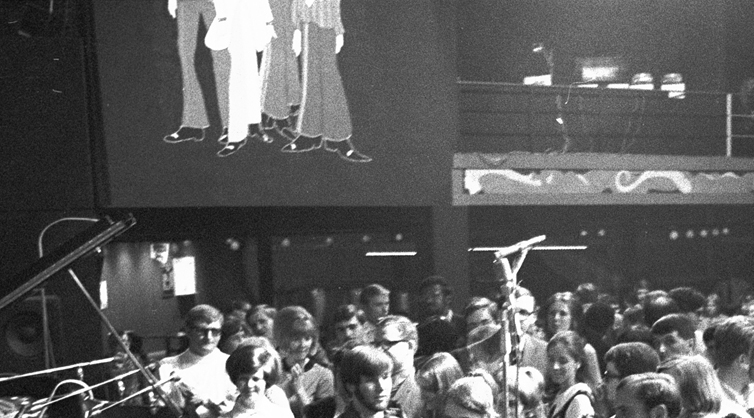
Photo copyright Mike Barich, St. Paul
Another photo from that Ramsey Lewis Show gives us an idea of what a sold-out show looked like back in the Depot days. The round things on the left are some sort of decor.
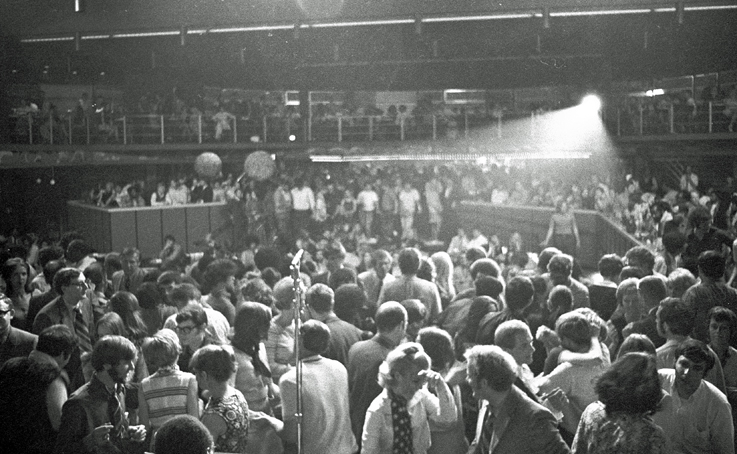
Photo copyright Mike Barich, St. Paul
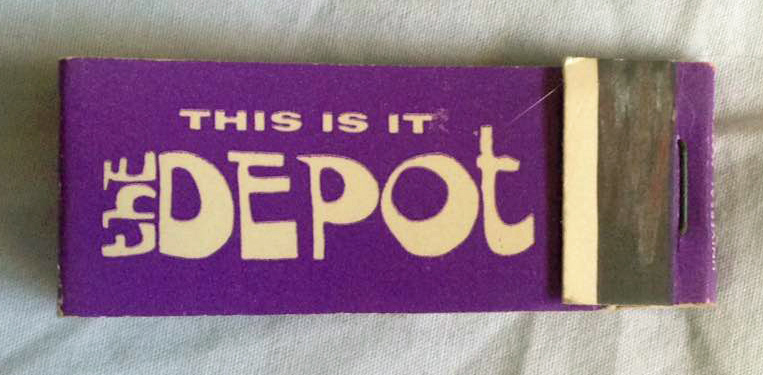
Image courtesy Terry Hallett
HOUSE BANDS
Although Danny’s Reasons were reported to be one of the house bands, they mostly only played Beer and Wine Nights on Mondays. (DS) Frequent house bands were more likely to be:
- Crockett
- Grizzly
- Suite Charity
- Ned
- The Sir Raleighs (who became Copperhead)
- Big Island
THURSDAY, APRIL 2, 1970 – VIP NIGHT
The night before Joe Cocker officially opened the Depot, the Committee held a party for the Media and 500 guests (250 + 1) to introduce the new venue. Danny Stevens remembered that Timothy D. Kehr helped put the guest list together. Film clips were taken of the new place, and TV interviews with prominent hosts such as Bill Carlson, Nancy Nelson, and Dave Moore were taped, to be broadcast after the last show on April 4 (and into late night April 5), 1970. Danny and WDGY Disk Jockey Jimmy Reed acted as MCs, and pizza was served.
Music was provided by the Paisleys, Cricket, and possibly Big Island – Danny’s Reasons and the Del Counts did not play that night.
JOE COCKER OPENS THE DEPOT
The Depot opened on April 3 and 4, 1970, and an estimated 2,300 people came to the club over the two days to see the Mad Dogs and Englishman tour featuring Joe Cocker.
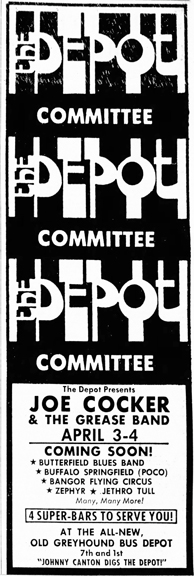
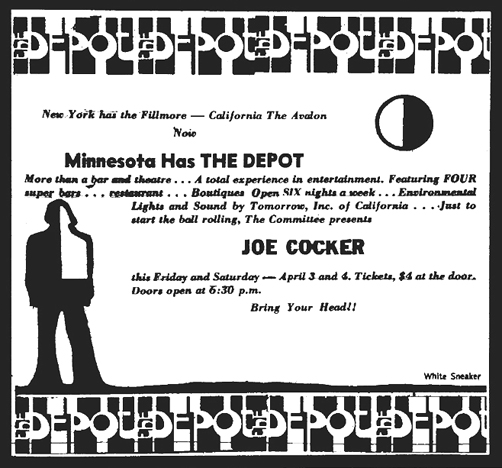
Ad from the Minnesota Daily, courtesy Robb Henry
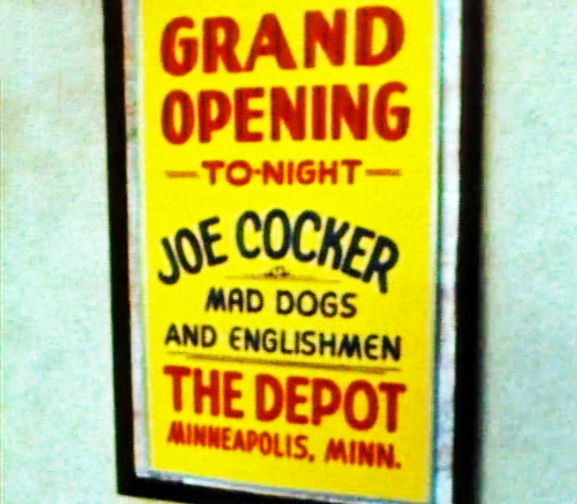
This is probably a screen grab from the movie, courtesy Alan Freed.
A photo of the poster was found being held by Cocker himself on the night of the opening!
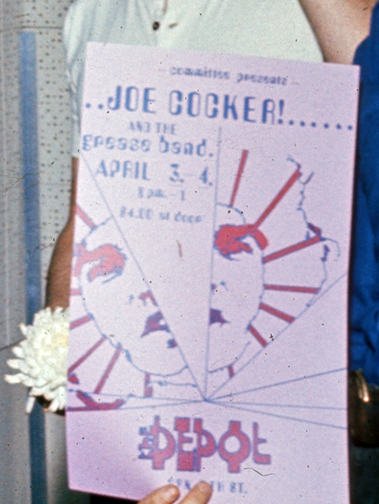
Photo copyright Mike Barich, St. Paul
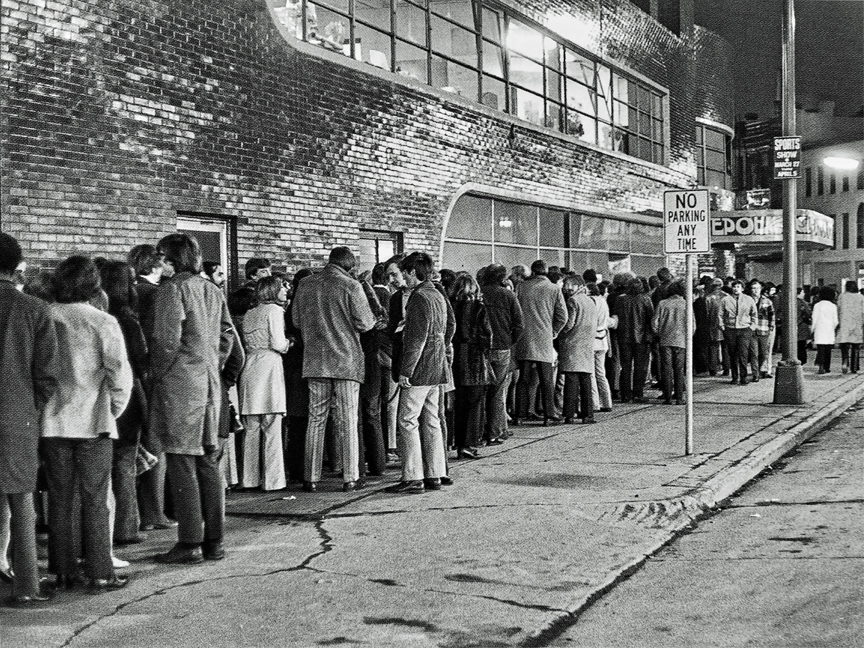
Photo of the outside of the Depot on opening night, courtesy Danny Stevens
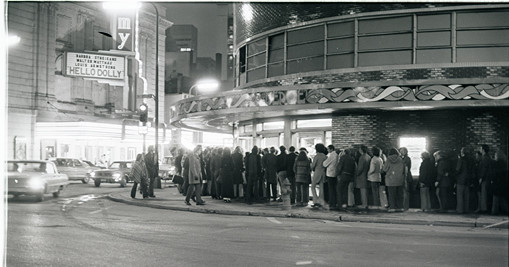
Another shot of opening night. Photos above and below by Powell Krueger, Minneapolis Tribune
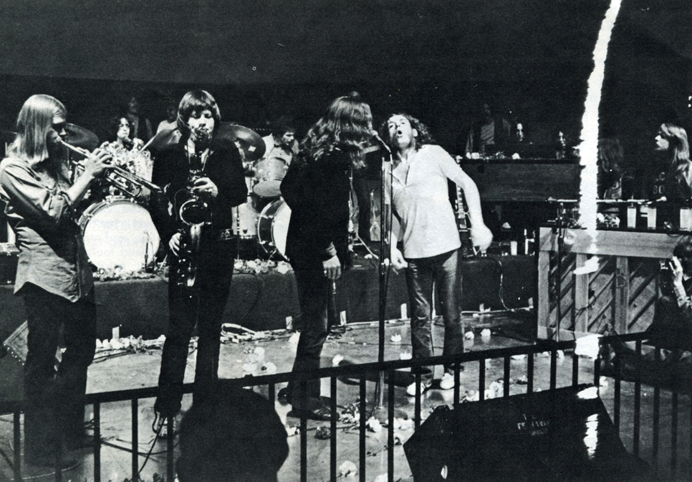
Photo copyright Mike Barich, St. Paul
Let’s bullet the factoids:
- Bill Graham had helped them line up Santana for the opener but it didn’t work out. (CR)
- Leon Russell was the musical director of this American tour, which descended on 48 cities over 60 days.
- The movie Woodstock, which introduced Cocker to many Americans for the first time, had just hit theaters a week earlier, so the timing was excellent.
- Personnel included 20 musicians, another 20 Englishmen on stage just for fun, two or three kids (allegedly on acid), and characters like the Lunar Teacake Snake Man, the Ruby-Lipped Essence of Lubbock, Texas, and the Mad Professor. Here’s one of the toddlers:
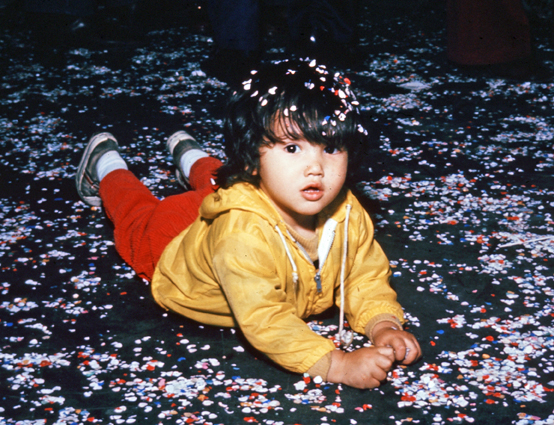
Photo copyright Mike Barich, St. Paul
- The enormous group of back-up singers was called the Space Choir. (CR) Two of the more famous members would be Rita Coolidge and Merry Clayton.
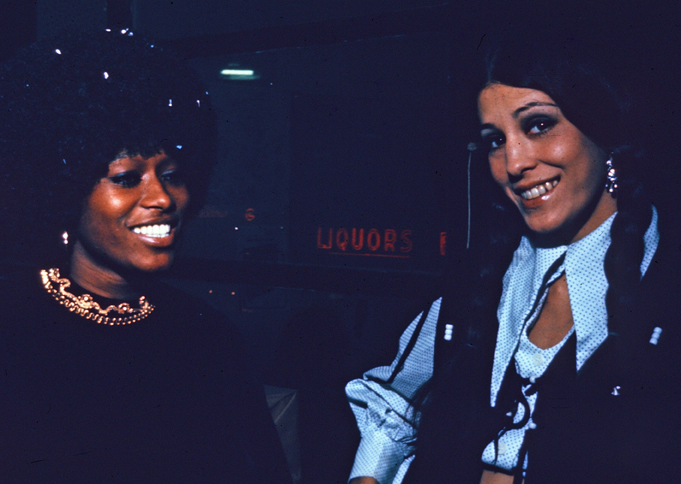
Photo of Merry Clayton and Rita Coolidge copyright Mike Barich, St. Paul
- Backup singer Pamela Polland’s fox terrier, Canina, had the run of the place, and infuriated Allan when she pooped on the stage. (CR) Here’s the dog, complete with “Cocker Power” tag.
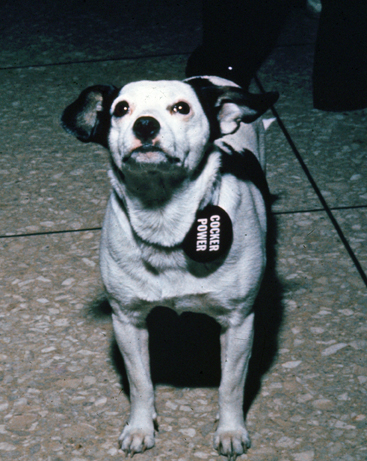
Photo copyright Mike Barich, St. Paul
- Tony Swan of the Twin Citian reported that Cocker was paid $15,000 for the weekend.
- Cocker’s manager demanded $7,000 more before the show, claiming that the booker low-balled the number of people expected. (CR, DS) Lawyers got involved when Cocker’s people threatened to pack up and leave, violating their written contract. When they found out that a call to the Teamsters’ Union would prevent this, the show went on.
- The Depot was the smallest venue on the tour, which had started two weeks before. (CR)
- Cocker’s people didn’t know they were inaugurating the new club. (CR)
- Allan ordered 2,000 carnations, which were thrown back and forth between the audience and the performers. (AF)
- On opening night it cost only $4 to get in, but there was a $10 charge for a table, with much poaching of seats going on.
In an interview on March 30, 2018, for Channel 5 news, Danny Stevens recalled, “Joe Cocker, I thought, was a real gentleman. I remember picking the whole group up at the airport. They came in on their own plane.”
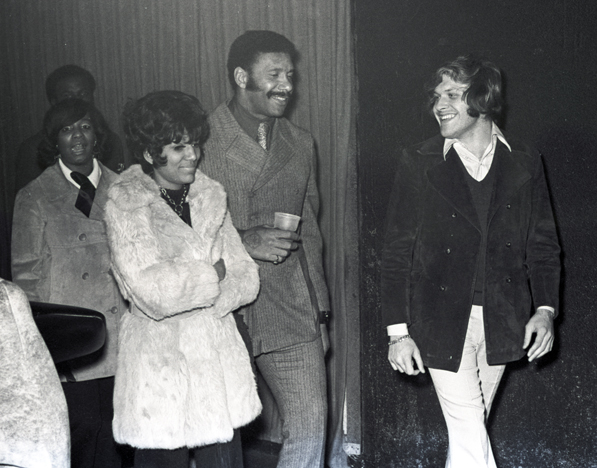
Danny with Minnesota Viking Jim Marshall and his family. Photo copyright Mike Barich, St. Paul
Johnny Canton, Program Director of WDGY Radio, acted as MC for the show.
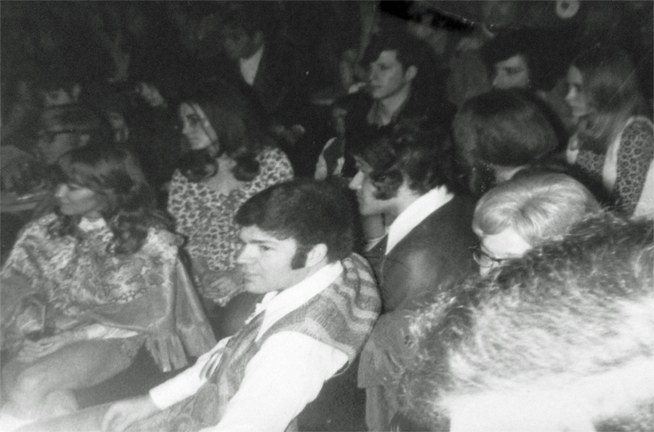
Johnny Canton, center, with Danny Stevens to his right, on opening night. Photo courtesy Danny Stevens
LOCAL ACTS
Thursday, April 2, 1970 – VIP Night
Danny remembered that three local bands played at the party put on for the Media and the Beautiful People of the Twin Cities, but was unclear about which ones.
Tim Emerson remembers that his band Cricket was one of them.
One of them could have been the Paisleys.
Neither believe that the Del Counts nor Danny’s Reasons were on the bill.
Perhaps the third was Big Island.
Friday, April 3, 1970 – First Night
There is a great deal of controversy about which local bands played during the two days that Joe Cocker opened the Depot. Connie’s Insider reported that local band booker Marsh Edelstein was upset that publicity about the concert did not include the bands that played before and between shows.
Many bands remember that they were the first to play at the Depot. Unfortunately, that elusive first band is not documented in any review that I’ve found. This is what we do know:
There was a “preliminary rock act,” according to Allan Holbert of the Minneapolis Tribune, (April 4, 1970).
Marshall Fine deemed the opening band “terrible.” (Minneapolis Star, April 6, 1970) When contacted in April 2023 to find out what he remembered, he replied, “Apologies. I don’t even remember there being an opening act, I’m afraid. Your search continues.”
Jim Gillespie of the Minnesota Daily called them “a trio of high school kids who probably wowed ’em at the Thanksgiving Turkey Trot but had no business playing at a place where it costs four bucks a ticket.” (April 10, 1970) The reference to youth made me think of Debb Johnson, but they had 7 pieces.
The two reviews above establish that it was a trio. One trio, Triad, didn’t move to Minneapolis until May 1970, according to minniepaulmusic.com.
A common suggestion was Crockett, but member Tom “Footie” Husting reported, “Wasn’t Crockett. We didn’t get together until after the Poco at the Depot gig.” Another member, Larry Hofmann, concurs. Besides, that band had four pieces. Crockett did go on to become the first “house band.”
Others suggested the trio Jokers’ Wild (which was called Flash Tuesday at the time), but member Denny Johnson remembered that the band was in Nebraska the entire month of April 1970.
Richard Timm says the Paisleys opened that night. But he also remembers that the Bangor Flying Circus performed next before Cocker, and that surely didn’t happen. In addition, it does not appear that the Paisleys were a trio, they were not unknown teenagers, and reviewers would have mentioned their name. Perhaps he was thinking of the night before, or the night after.
Charles Schoen says the Del Counts opened that night. For the same reasons as above, the Del Counts are unlikely. They were not a trio, they were well known, and they already had over ten years’ experience. It is very possible that they performed between shows, however.
Bear, Beaver, Peacock
Will Jones and his wife lasted about two minutes at the opening before his ears gave out. The opening band was TOO LOUD. The photo below accompanied his column – it is a terrible, grainy photo, but it shows a trio.
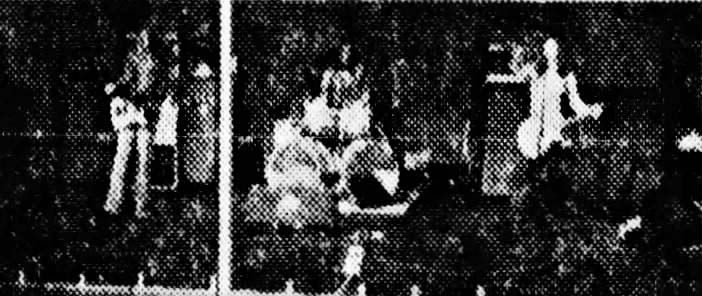
Minneapolis Tribune, April 6, 1970
One possibility might be Bear, Beaver, Peacock. The photo below was taken on September 17, 1970. This is not very likely, however, since this was not one of Marsh Edelstein’s clients.

Mark Lundeen (guitar), Rick Hochstein (Bear-drums), Mark Harland (bass). Unknown singer. Photo copyright Mike Barich
Steve Barich was too busy running the light show to be paying attention. Larry Loofbourrow, who was running sound and the light show, understandably doesn’t remember 53 years later.
On April 4 the supporting acts were Kaleidoscope and the Paisleys. (no citation)
Another account says that Pride and Joy performed, and Cricket was scheduled but was bumped for time. (no citation)
Please Contact me if you have any recollection of this important fact about the Depot!
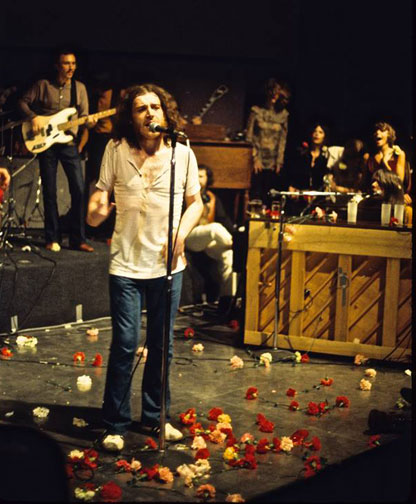
Photo copyright Darrell Brand
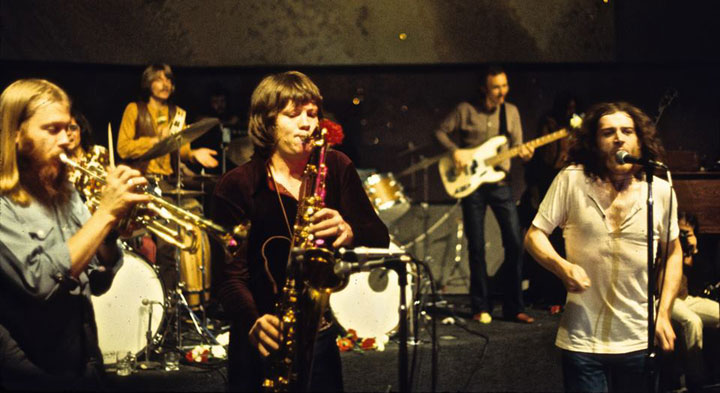
Photo copyright Darrell Brand
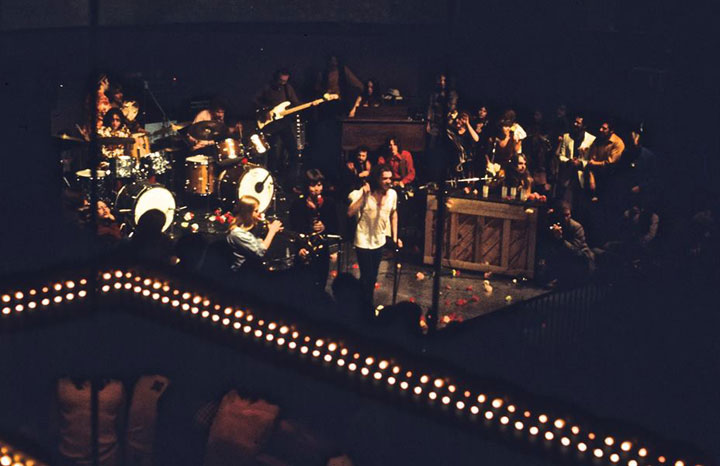
Photo copyright Darrell Brand
REVIEWS OF OPENING NIGHT
MARSHALL FINE
Marshall Fine’s review of opening night in the Minneapolis Star was scathing, citing bad planning, expensive drinks, a long wait to get in, an opening band that was “terrible,” and the fact that Cocker’s first set was only 20 minutes long. Fine was a student at the U of M at the time, and complained that the under-21 crowd couldn’t get in. He did appreciate the “exquisite show” put on by Cocker, but said that the “audience’s response was comparable to that of an equally drunk group shouting ‘take it off’ at the Roaring 20s.”
ALLAN HOLBERT
Allan Holbert’s review in the Tribune’s was more focused on the sheer numbers of people who showed up, saying that people were lined up four-deep around the block. “Not since the truck drivers’ strike of 1934 is it likely that there has been such excitement, such chaos, such congestion, such noise just off Hennepin Av. as there was Friday night.” Allan Fingerhut said that they ran out of booze by 8:00 and had to send out for more.
Holbert’s account, which later calls the space the Fillmore Upper Midwest, says that carpeting and other interior decorations weren’t yet installed, but the old bus station was packed by the time Cocker hit the stage just after 8 p.m. Cocker worked hard on a stage filled with 40 people, “singing like a black man, which he isn’t and doing his dancing stuff like a spastic, which he isn’t either.”
TWIN CITIAN
Tony Swan’s account in the May issue of the Twin Citian said that the “beautiful people,” many wearing “Cocker Power” buttons, numbered 2,000, which was 600 over capacity. He said that the first show was a dud, with too much noise and confusion and older people holding their ears and beautiful people “with resplendent sun tans and $250 hippie outfits” more interested in checking each other out than listening to the music. But between sets “the ingredients underwent an important purge. A lot of the older people, having seen enough, went out the door shaking their heads in disbelief, their ears ringing. The beautiful people made a determined and lengthy run on the bar, lowering their inhibitions in direct proportion. And the hard core rock freaks moved in on the privileged table area, surrounding it, engulfing it.”
During the second set, “Everyone – everyone – began swaying in time to the music, which became so loud that it was beyond the audible – it was simply deafening. People began throwing flowers onto the stage and the musicians began throwing them back, strengthening the two-way process. … And Cocker kept pouring more and more of himself through those big banks of amps… until he was finished and just stood there, smiling amid all the flowers.” Fingerhut had provided the Carnations.
Swan’s article gives a detailed description of the Scene:
The curved wall which used to embrace the gates to departing buses is now the backdrop for a large, purple plush-covered stage. On the wall above the stage, Cinemascope style, there is a large screen. While the performers are wailing, batteries of projectors – in all eight carousel slide projectors, four opaque projectors and a 16-milimeter movie camera – shoot images onto the screen from either end of the horseshoe shaped balcony which surrounds the main floor. There are also colored spotlights and strobe lights – all the usual implements of psychedelia. There are five bars, three on the main floor and two on the balcony. There is a large, prime table area right in front of the stage: on opening night the tables went for 10 bucks a head, which could get to be a drag on the Depot’s income potential in the future.
MINNEAPOLIS FLAG
A reviewer named Greg noted in the April 10, 1970, issue of the underground magazine The Minneapolis Flag that what seemed like the entire Tactical Division of the Minneapolis Police Force (off duty) had been hired as floorwalkers and bouncers.
WILL JONES
Will Jones tried to cover the opening, but the sound inflicted so much physical pain that he speculated that the young people had developed leather eardrums to survive.
What’s been created there is an environment in which no creature born before 1940 can survive. …
The generation-communications gap may be entirely a physical thing, you know. I never wanted to communicate with one of these creatures more in my life than when a lush, bell-bottomed, dewy-smiling young blonde came over to me and moved her lips in a way that I knew, from experience in the outside world, meant that she was speaking to me. But the only sound I could hear was that which came from the amps. I stared at her, dumb and helpless. Maybe she thought I began to cry, but the tears that came to my eyes were as much from the smoke, I’m sure, as from frustration. That’s another thing that the sound does in places where these creatures and their favorite performers gather. It blocks the ventilating system with great globs of sound, and no smoke ever escapes a club or all in which rock music is performed, no matter how well-intentioned the architects and engineers may have been.
Jones lasted about three minutes until he and his wife escaped to more sedate environs.
CONNIE’S INSIDER
Connie Hechter’s review in his April 11 – 18, 1970, issue was evenhanded, citing both the positive and negative aspects of the venue and the show. He even reviews the other reviews. It’s a long piece, but I’d like to quote it in full.
Depot Opens With a Cocker Named Joe
The long heralded opening of The Depot, Minneapolis’ newest downtown night spot, took place last weekend, April 3 and 4, 1970, with that great white blues singer, Joe Cocker and his pop version of the Beverly Hillbillies in residence on the large, well-lit stage which workmen, working in mass confusion with great pressure to ready the joint in time, finished minutes before the overflowing crowds swelled into the club.
The reviews [of the club] in the daily papers were mixed. Some critics liked the club, but others seemed to miss the entire potential capabilities of the Depot becoming one of the great havens for entertainment in the Midwest if not in the entire country.
First off, the Depot can be the ideal night spot for rock or any other kind of entertainment. The place is big enough to hold more than a thousand customers, with seating for several hundreds. Many night clubs suffer from lack of size (you need lots of people to support the acts people want to see, as most name acts are priced in the “expensive” category). I mean, imagine a bus depot for a night club…. What could be better? Besides, the Depot just happens to be located in the heart of the downtown loop, a short block off our “great white way.”
Next, the man guiding the Depot’s operations and footing the bill for the massive decoration required, Allan Fingerhut, poured hundreds of thousands into his project, unlike some clubs which open with a bare minimum of capital and decoration. Fingerhut and his sidemen, Danny Stevens, Abby Rosenthal, Skip Goucher, and Clearance (sic) Kramer did most everything in a first-class manner. The fact that some parts of the operation did not function accordingly on opening weekend could only be attributed to a rush, rush schedule to get the doors open in time which translates to lack of planning and organization. This will straighten itself out, as Mr. Fingerhut and company, known as Allan’s Committee, are well aware of the shortcomings that took place last weekend.
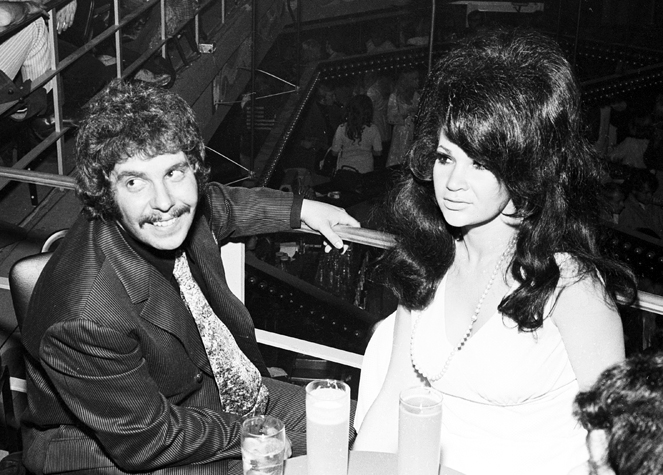
Allan and Sharron Fingerhut at the Depot opening. Photo copyright Mike Barich, St. Paul
So now you have a big club done up in a more-than-respectable atmosphere with accent on the mod generation, the young hip people who make things happen.
Did anyone take close notice of the superb light show and screen upon which it was reflected? It was a real, wraparound screen that does justice to the best Cinerama pavilion in town…. Not a bunch of sheets stringed together, hanging from the ceiling. Not that anything is wrong with a bunch of sheets, but imagine what it’s like to work with an honest-to-goodness screen.
The sound system is good, and the acoustics are excellent for a musical rock show. (More about this later.)
Perhaps the best thing about the Depot as far as catching rock acts within its walls is the important fact that one can buy a drink, unlike catching a show at the Auditorium or Armory etc. One doesn’t expect to buy drinks at the latter, but imagine digging an act with a cold glass in your hand (you over 21 people).
Perhaps now you can begin to comprehend the possibilities this club can provide. Not only rock shows but big bands and small circuses can perform now in downtown Minneapolis.
Many people were miffed that the opening scene was so crowded and the promised tables were not available, as people were sitting everywhere, whether or not they held tickets for tables. This situation never should have happened; monitors should have seen the $10 ticket holders and the press to their tables. But again, the schedule was so hectic that the place was lucky to get the doors open. Now that they did that, they can worry about the reservations and such, and the public will have to forgive the mix-ups experienced on April 3 and 4.
Other people greeted with shock the news that the club is off limits to the under 21 crowd. This is a shame for those in this category, but it is unavoidable, as the Depot dispenses liquor and beer.
One reviewer commented that the Depot is missing a substantial market by not allowing the kids into the shows. The management is well aware of this. However, they opened a night club with booze, and did not intend it to be a concert hall for the younger people. Perhaps they will provide concerts on weekend afternoons for those who cannot legally attend during evening hours.
There are those betting that the club will not “make it” for six months. I’m betting it will, provided Fingerhut tightens up the operation, sells drinks to the masses, and provides us with good national and local acts. He says this is exactly what is planned, so let’s get behind the Committee and help Allan and his gang in their efforts to make the joint successful.
[A photo of Fingerhut bears the caption:] Cocker and his Mad Dog musicians put on one of the greatest shows of the year, so far. Allan Fingerhut, left, owner and guiding hand of the Depot, smiles as the pressure to get his club open in time is off. He was happy with the results of the club’s opening weekend. And he enjoyed the Cocker show. So did 2,300 other people over the two night stand.
MAD DOGS AND ENGLISHMEN
The shows were filmed and appeared in the movie “Mad Dogs and Englishmen” along with other shows on the same tour.
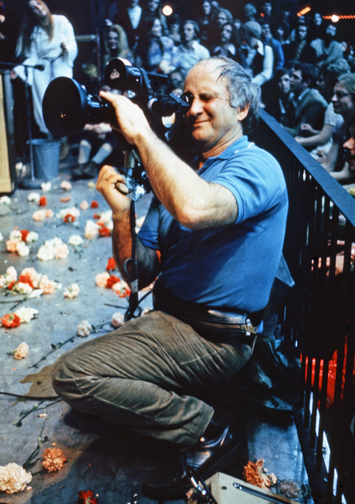
Photo copyright Mike Barich, St. Paul
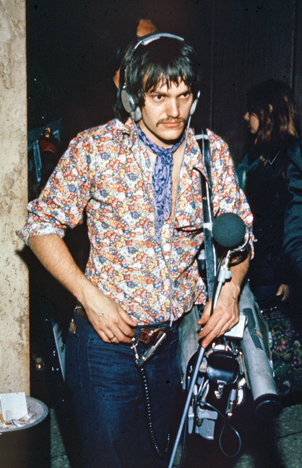
Photo copyright Mike Barich, St. Paul
The first time the movie came to local screens it came and went fairly quickly.
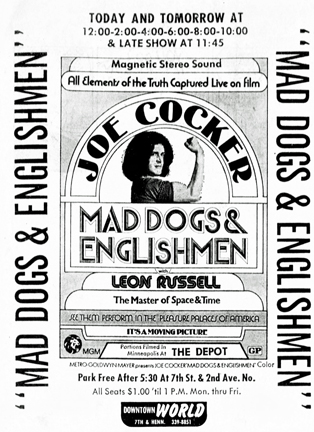
May 7, 1971
CIRCUS MAGAZINE
Mike Barich’s photo of Cocker – holding a carnation – appeared on the cover of the August 1970 issue of Circus magazine.
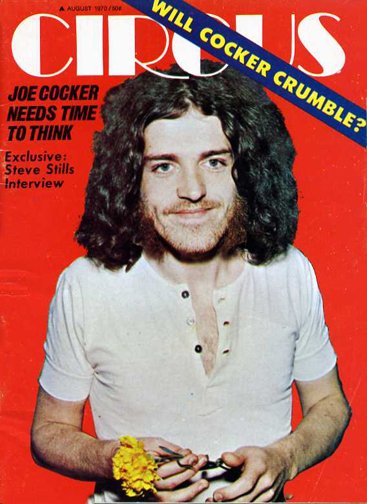
COCKER RETURNS
The Star Tribune, December 22, 2014, reported:
Cocker returned to the club one more time when it was called First Avenue in 1994, the same year he played the 25th anniversary Woodstock festival. However, he could not remember the 1970 gig nor the venue when Jon Bream interviewed him in 2009 before what would be his last Twin Cities area performance, at Mystic Lake Casino. He said, “The Depot? I’ll have to run it by Chris Stainton [his longtime keyboardist]. It doesn’t ring a bell at all to me.”
John Robert Cocker, known to family, friends, his community and fans around the world as Joe Cocker, passed away on December 22, 2014, after a hard fought battle with small cell lung cancer. He was 70 years old.
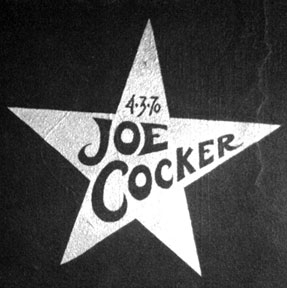 Cocker’s star at First Avenue
Cocker’s star at First Avenue
OTHER DEPOT SHOWS
April 11, 1970: The Butterfield Blues Band (relatively small crowd)
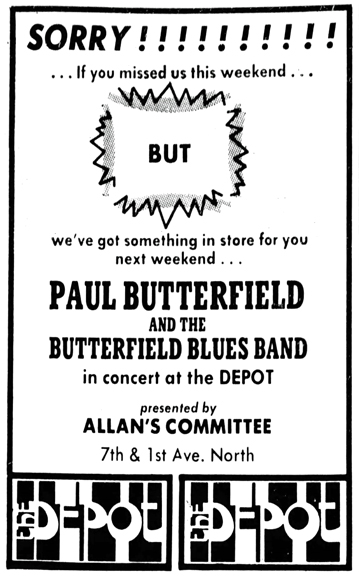
Ad from Connie’s Insider, April 1970
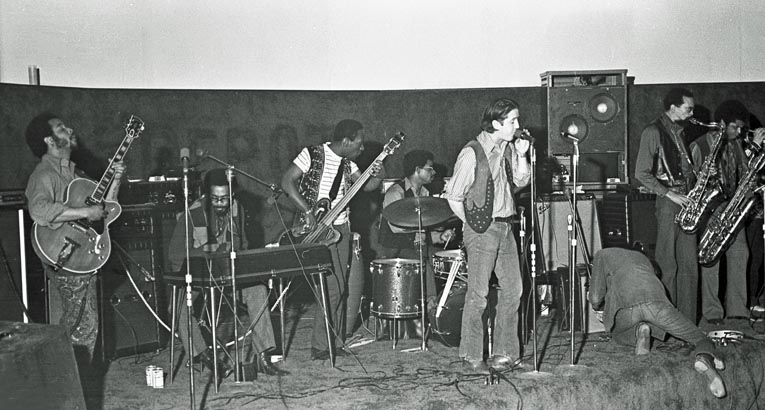
Photo copyright Mike Barich, St. Paul
Underground newspaper Hundred Flowers had an adversarial relationship with the Depot from the start, it seems. In its April 17, 1970 issue, there was this:
the decor: amazingly tasteless
the room: amazingly tiny
the floor: amazingly crowded
the liquor: amazingly costly
the sound: amazingly loud
Cocker & Butterfield: amazing!
April 17-18, 1970: Poco, opened by Big Island and the Hot Half Dozen. (Crockett also remembers opening)
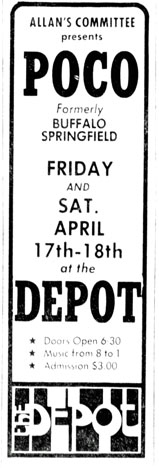
Minneapolis Star
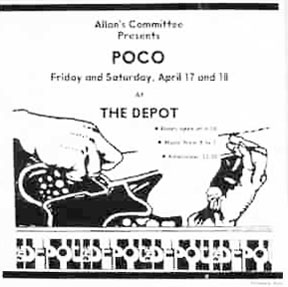
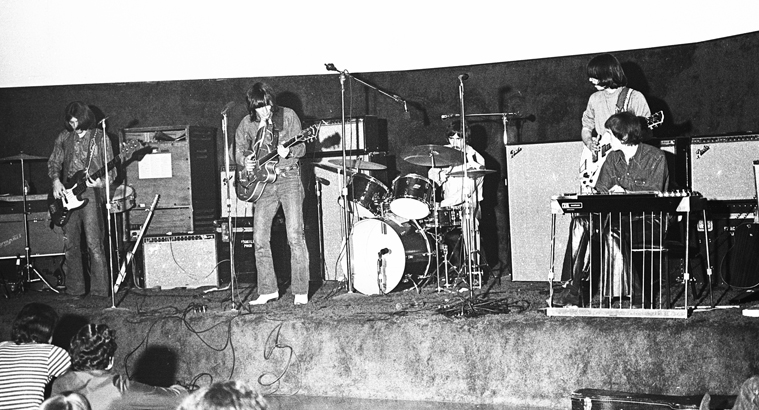
Poco photo copyright Mike Barich, St. Paul
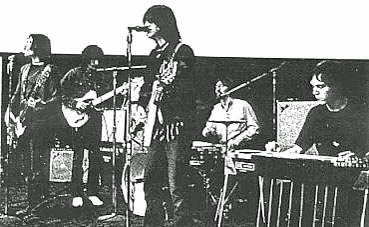
Photo from the Minnesota Daily
Richie Furay and Jim Messina, formerly of the Buffalo Springfield, made up the nucleus of Poco, and according to reviewer Marshall Fine, put on a fine show. Furay, a country music fan, made Poco into one of the first country-rock bands. They played songs from their first album and from their yet-to-be released second album. Fine had exemplary things to say about each member of the band, and headed his review “Poco show builds to stunning climax.”
Fine also had this to say about the venue itself:
The Depot, in two weeks, has mellowed quite a bit. The crowd is smaller, quieter. The whole atmosphere is calmer than when it opened. Its potential is considerable and it has turned into, generally, a pretty nice place.
Review of Poco by Ron Dachis of the Minnesota Daily:
Poco, a down home country-rock group eased into the Depot Friday night with little fanfare. But before the evening was over they had captured the small, yet receptive audience, with the ever-improving Poco sound.
From the rich sampling of new tunes we heard Friday night, especially in the second set, it appears that Poco has found itself and is well on the way to much greater success.
The bad seems to be taking more shape. It can most aptly be described as a rock band with a country feeling. The ever-present pedal steel guitar and tenor harmony produce the country effect. Hard working drummer George Grantham and bassist Tim Schmit lay down the rocking beat.
The first set started with Richie’s “Come On,” a real rocker that set the tone for the evening. Then Richie did “A Child’s Claim to Fame” for old times sake. After this number the group seemed to relax and “Anyway Bye Bye” a blues cut from their new album went really well.
“Grand Junction,” an instrumental that featured Rusty on pedal and dobro, won the crowd. Jim’s lead guitar intertwined with Rusty’s expert picking.
Next was “Consequently So Long,” “Don’t Let It Pass By,” and a new version of “Nobody’s Fool.” “Don’t Let It Pass By” featured some excellent harmonies. The new version of “Nobody’s Fool” displayed extended instrumental solos by Rusty and Jim. George and Tim were driving away while Jim came off the stage to play amongst the crowd.
They closed the first set with “El Tonto de Nadie, Regresar,” written by the whole group which, when translated means “Whatever happened to the Kinks?”
Poco returned to a somewhat warmer response for set two. This set included three cuts from the first album: “Calico Lady,” “What a Day,” and “Pickin’ Up the Pieces.” The rest of the songs from the new album were played and one thing became evident as the evening progressed. This group has found itself. The players are all doing the same things together with the same ends in mind. This singularity of purpose and tight control constitute Poco’s music.
Poco has decided exactly what they want to be doing and they’re following it through. Their new release will undoubtedly outshine the first. Poco’s development can possibly be attributed to their attitude which is much like the final song they played, “Keep On Believing.” They believe in their style, believe in their music, believe in their people. Poco made a lot of friends this weekend.
Another review, this time from Hundred Flowers: (most typos fixed)
Poco is beautiful and just what I’ve been waiting for. They’re better than ever, too. Randy Miesner, who played bass on Picking Up the Pieces, is now a gas jockey somewhere in Nebraska and Poco has made the perfect replacement. Tim Schmit’s excellent musicianship, smooth tenor voice and little brother smile fits him right into place alongside the others, already renowned for their harmonies of spirit and voice. In fact, his voice is almost indistinguishable from Richie Furay’s, who, along with bass guitar Jim Messina (lead guitar and pedal steel with Poco) was as instrumental as any Steve Stills or Neil Young in creating the Buffalo Springfield sound.
With Neil’s brother Rusty Young on organ and George Granthum on Drums, the Poco sound is just as distinctive and just as special. Their tenor voices (all but Young sing) sound like four Richie Furays or about one octave below the chipmunks and two octaves below Graham Nash.
One poster indicated the Mitch Ryder was at one time scheduled to be on the bill with Poco on April 18, 1970.
April 24, 1970: Bangor Flying Circus, opened by Zephyr
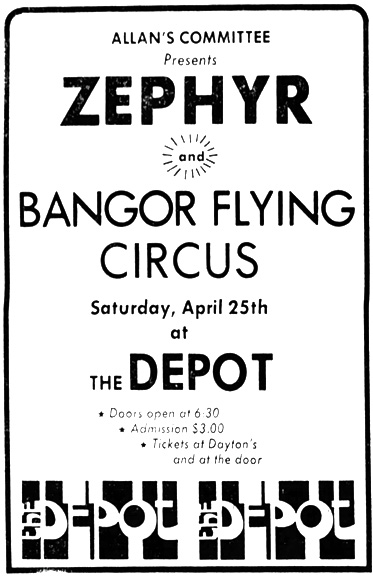
One poster gave the dates April 21 to 24, 1970 for this appearance.
The same poster showed Bangor Flying Circus and Zephyr scheduled for April 25, 1970.
Also appearing in April:
White Lightning
The New Reasons
Faith
The Paisleys
The Del Counts
May 5-9, 1970: The Ramsey Lewis Trio. Danny’s Reasons opened on May 8. Blues Image opened on May 9.

THEM CHANGES
On May 8 and 9, 1970, Lewis’s concert was recorded for his album “Them Changes,” which was released as Cadet Records LP 844 in October 1970.
Lewis alternated between a grand piano and an electric piano.
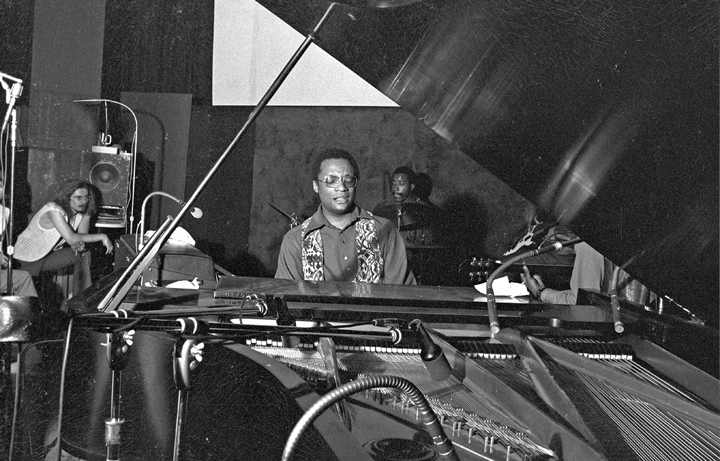
Photo copyright Mike Barich, St. Paul
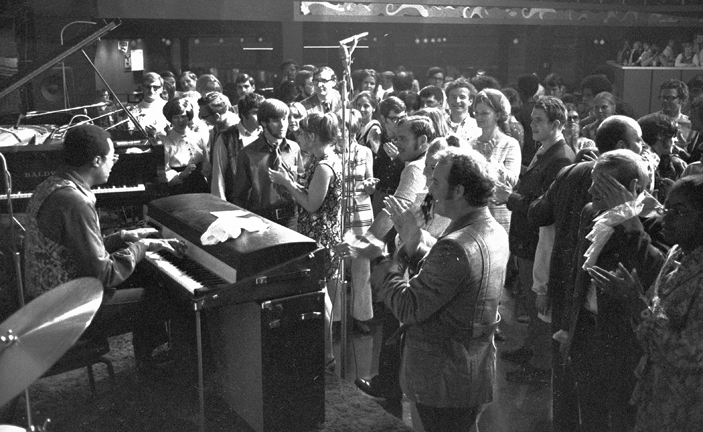
Photo copyright Mike Barich, St. Paul
The Track List, courtesy of discogs.com:
| A1 | Them Changes | 6:40 |
| A2 | Drown In My Own Tears | 7:25 |
| A3 | Oh Happy Day | 7:10 |
| B1 | Do Whatever Sets You Free | 7:53 |
| B2 | Something | 5:15 |
| B3 | See The End From The Beginning, Look Afar | 6:15 |
| B4 | The Unsilent Minority | 3:45 |
The Credits, again according to discogs.com:
- Steinway Grand Piano, Fender Rhodes Electric Piano: Ramsey Lewis
- Electric Fender Guitar: Phil Upchurch
- Bass [Electric Fender Bass: Cleveland Eaton
- Drums: Morris Jennings
- Arranger, Producer, Concept by Ramsey Lewis
- Engineer: Reice Hamel
- Mastered by George Piros
- Artwork by Dick Fowler
- Photography by Alan Levine
- Supervised by Dick LaPalm
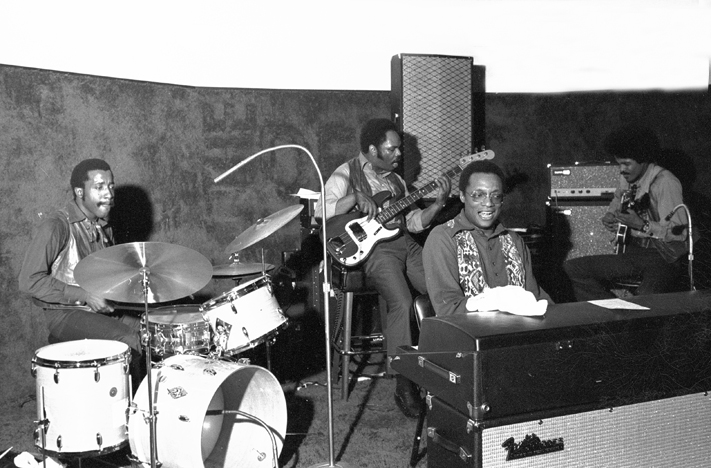
Photo copyright Mike Barich, St. Paul
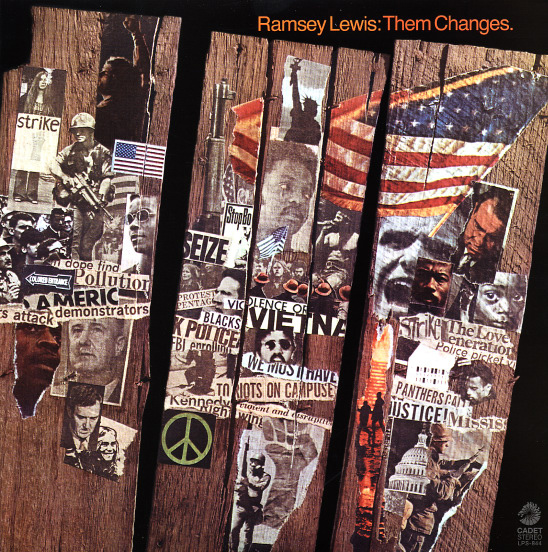
May 17, 1970: Mitch Ryder and Mojo Buford Blues Band. Delaney and Bonnie were originally scheduled to be the main act, opened by Ryder.

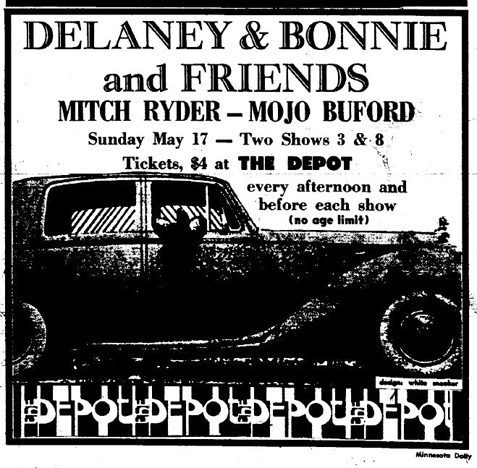
Ad from the Minnesota Daily courtesy Robb Henry
When Delaney and Bonnie cancelled, Ryder moved up to be the headliner. Robb Henry remembers, “Will Agar and I were the guitarists with Mojo Buford on that show. I was really impressed by Mitch Ryder’s guitarist Steve Hunter.”
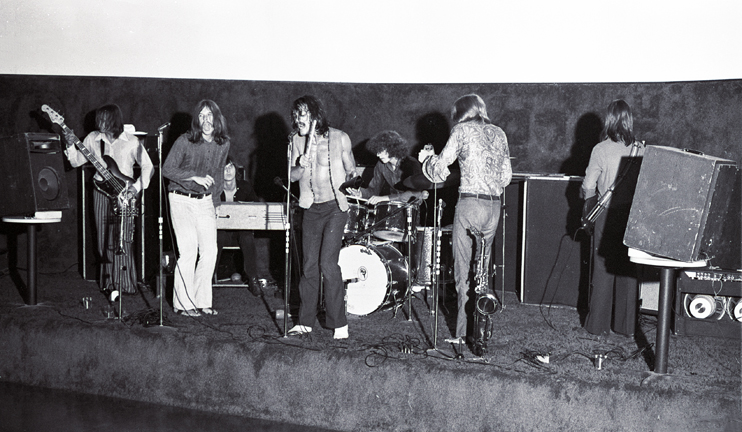
Mitch Ryder photo copyright Mike Barich, St. Paul
Perhaps because of the substitution, there was a pretty sparse crowd.
May 22-23, 1970: Kinks, opened by Crockett. This was the first appearance by the Kinks in the Twin Cities.
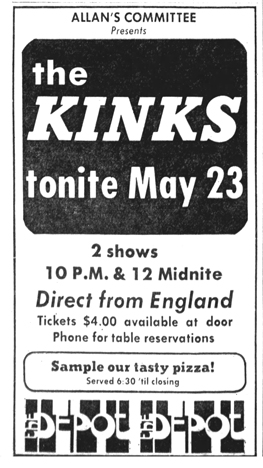
Minneapolis Star
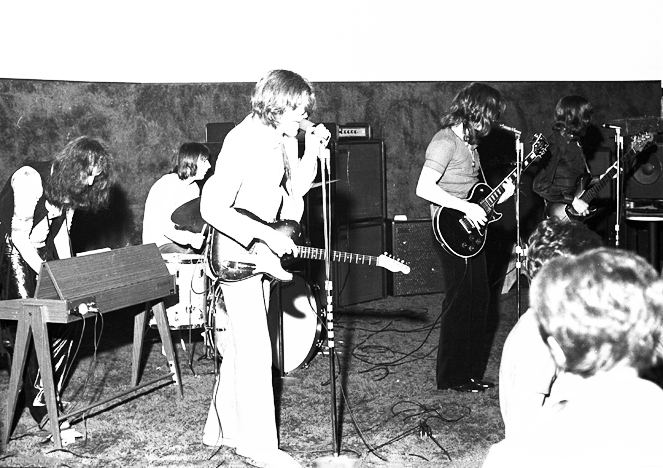
Photo of Kinks copyright Mike Barich, St. Paul
There was a low turnout for the shows, reportedly, as there was a lot going on that weekend. On Friday, May 22, a “Footbridge Festival and Day of Life” took place at the U of M. This event featured David Dellinger, defendant in the Chicago 7 trial; “two mild protests;” rock bands playing on and off all day; and a free concert by Phil Ochs at 8:30 pm. (Minneapolis Star, May 23, 1970) On Saturday, May 23, a “Conference on the Black Panthers: Target of Repression” was held at the Unitarian Church.
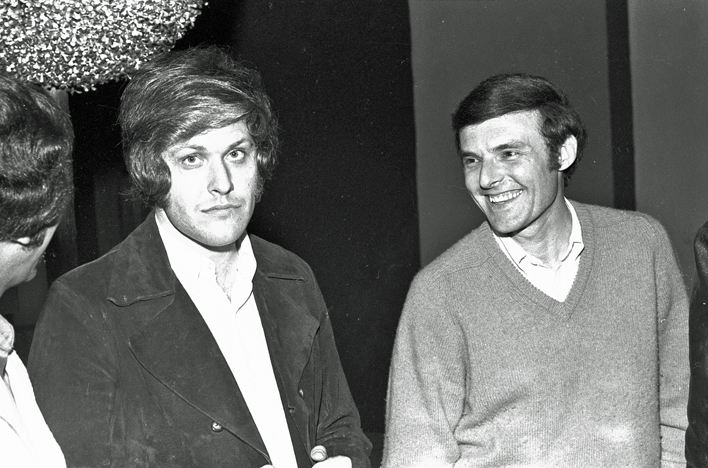
Danny and WDGY DJ Jimmy Reed at the Kinks concert. Photo copyright Mike Barich, St. Paul
Both the Minneapolis Tribune and Minneapolis Star reported on Friday’s show only.
Scott Bartell opened his piece with a review of the Depot itself, after the ticket taker complained that the press was giving the place a bad rap.
On the good side, The Depot has beautiful acoustics and brings in very fine groups. Even the local groups are at least pleasant. The drinks are good and not too expensive and our waitress was friendly and attentive. It is clean and, if you are going to drink, tables are a good idea – I’m glad they added more of them to their original seating arrangements.
But the atmosphere is still very much “money” and it does not make one feel warm and receptive. The freedom of rock was not in the air.
If the Kinks, the featured group, are any indication, the performers may feel the same vibrations. Their set was less than half an hour long, and was very fast and without much emphasis…
Last night they seemed to be smoother and faster than in their recordings, almost as though they were in a bit of a hurry… (Minneapolis Tribune, May 23, 1970)
Reviewer Jim Gillespie, who saw only the first show, voiced disappointment in the performance after waiting for six years for the Kinks to come to the ‘Cities. Again he noted the short first set, and said that the group did no material from its “much-touted rock opera” “Arthur (Or the Decline and Fall of the British Empire).” They opened with “The Last of the Steam-Powered Trains,” then the obligatory medley of their older hits. The high point for Gillespie was a tune sung by Dave Davies called “You’re Looking Fine.”
Dave’s voice is harder and more gutteral than Ray’s and eminently suitable for singing blues. His guitar work on the song was the best best he played, piercing sustained notes and staccato runs, perfectly complementing the chopped-off rhythm pattern laid down by the rest of the band. (Minneapolis Star, May 23, 1970)
And this was the first and last time we hear that there is pizza available!
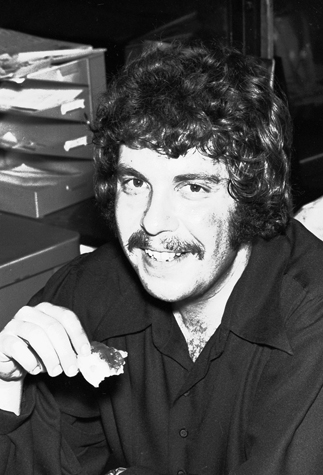
Allan sampling the pizza – photo copyright Mike Barich, St. Paul
ALLAN’S COMMITTEE
You may have noticed that the ads for the last six shows (starting with the second show) referred to “Allan’s Committee.” Danny, as Allan’s partner and co-founder of the Depot, was incensed at this and thought about suing, but Allan’s brother-in-law, Ted Deikel, was brought in as a mediator and worked out an agreement that the phrase “Allan’s Committee” would no longer be used. They also agreed that they would vote on all bands to be booked. (DS)
David Roth, a producer for tpt who made a documentary on the 50th Anniversary of the venue in 2020, interviewed Allan, and asked him about the “Allan’s Committee” tag on the ads, and said that Allan didn’t remember that happening.
Whatever the case, after those six shows, the phrase was no longer used.
May 31, 1970: Jethro Tull, opened by Clouds
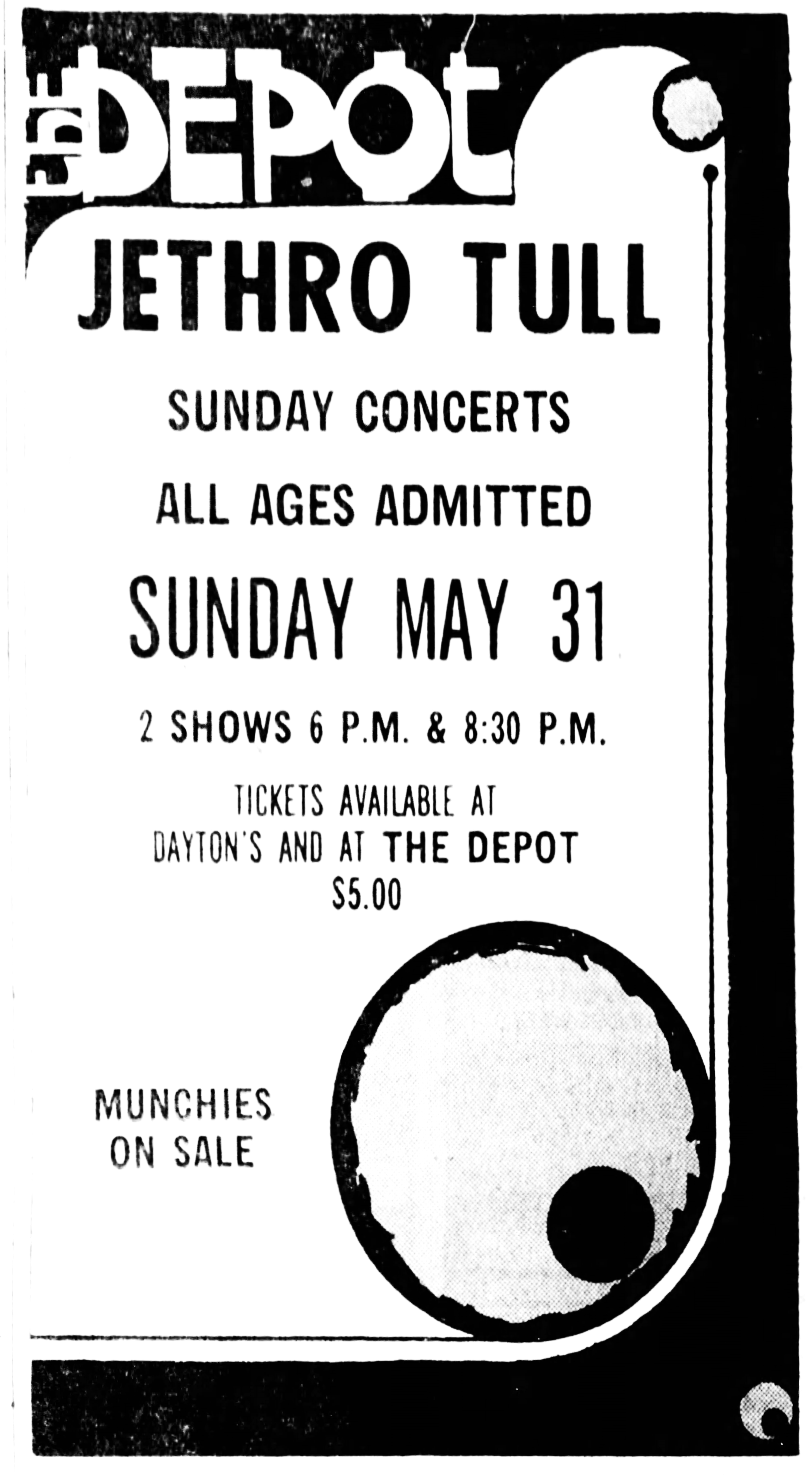
This show was open to teens under 21 – no alcohol was served. Unfortunately, the air conditioning was not yet installed, and the kids worked up quite a sweat.
Peter Altman of the Star was disappointed at the first show. Although he found the group to be outstanding, he posited that they had not become “super-popular” because they don’t stand out.
What was missing in the first set was individuality and a quality one might call repose or ease. There was little sense that the musicians had anything very personal to say. Wit was not pronounced. Solos lacked variety. There was not a great deal of attention devoted to free musical conversation. Often the musicians seemed to be playing by the book or off in their own private worlds.
Make no mistake. The sounds Tull provided were superior. The quintet has substance, and Anderson has showmanship, too. Tull played about an hour and a half and never dried up. They gave enjoyment. But whether or not they were up for their first set Sunday, they didn’t really switch on the Depot crowd of perhaps 500. There seemed to be thousands of people in line for the second show as I left the old Greyhound terminal. Maybe that inspired a really exciting session.
Ron Dachis, reporting for Hundred Flowers, was there for the second show and reported a block-long line eight people wide stretching along 7th Street, overflowing into the streets, waiting for the first show to end.
Will Shapira’s review for the Insider reported that the Depot was “pretty full” for the first set and “absolutely jammed” for the second. And the quality of the two shows were markedly different as well:
The group somehow got fouled up in its first set and never approached the heights they were to reach later in the evening. There seemed to be two main causes of their difficulty: equipment failure and a proclivity to veer away from their energizing group sound into long, boring, empty ego-trip solos. New keyboard man John Evan, lead guitarist Martin Barre and drummer Clive Bunker were all guilty; even the group’s dynamic leader, Ian Anderson, was off his form in that first set.
The second set was something else, again, however… and it was all the more remarkable because the group played the very same tunes both sets!
. . .
Jethro Tull had not only flown us into a new day and month but, hopefully, The Depot had moved us into a new period of musical experience and excitement.
The opening act was Clouds, a Scottish band touring with Jethro Tull. On this day they were also having equipment problems. Altman deemed the trio “tedious;” Dachis called Clouds “repetitious and dull.”
THE DEPOT AFTER HOURS
An early but apparently short-lived promotion was to target the after-work crowd and tempt them with the beautiful people they might meet at the Depot. Below, a woman eating a flower meets a local Tom Jones … This is the only ad like this I found.
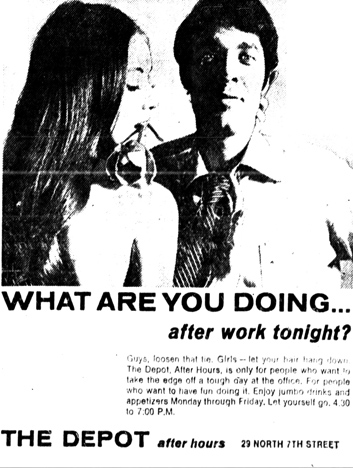
Minneapolis Tribune, June 2, 1970
June 6, 1970. Sha Na Na made a special guest appearance (they were scheduled for the next night) and Hundred Flowers reported that the 21 and over crowd was not especially impressed.
June 7, 1970: Sha Na Na did its regularly scheduled show on teen night.
Fifty years later, someone in the audience said: “I remember distinctly Bowser saying, ‘Just one thing to say to all you fucking hippies: Rock and Roll is Here to Stay!'”
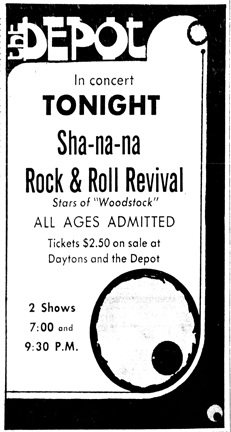
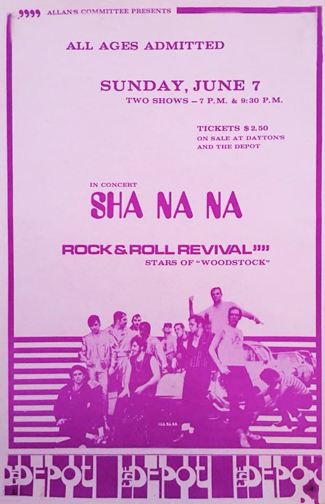
Hundred Flowers (Tom Utne?) said the younger crowed “showed the Depot what audiencing was all about.” As usual, HF had a beef, though:
Just to let you folks know, neither Sha-na-na nor anyone else gets anything extra for doing two shows. They just cut ten songs out of their regular set and do it twice. … Hasn’t the time come when Minneapolis is no longer considered a sucker-town by musicians and promoters?
Marshall Fine reported that the “audience alternately laughed at and cheered the group’s antics, were they hair combing or doing the twist.
Sha-Na-Na’s act is slick, possibly even greasy. The group spits, scowls and does its best to ape James Dean. It is more musically talented than it first appears, and also wildly funny. The humor in the group’s act depends on the ability of the audience to laugh at itself. For Sha-Na-Na is satirizing American youth as it was. Few in the crowd were too young not to remember the songs and styles mimicked. The humor could easily be misplaced. If any member had the slightest disdain for what he was doing, Sha-Na-Na’s hole thing would have come off ass too campy and the joke could have disappeared after the first song. Sha-Na-Na takes its role very seriously on stage, however, and it can create the mood that reigned in the days of the four-chord progression.
Adding to the atmosphere last night was the fact that the Depot’s air conditioning was not working. The sweaty, steamy temperature provided the decor that probably existed in the oven-like auditoriums of yesteryear.
This next part of Fine’s review needs clarification:
Danny’s Reasons preceded Sha-Na-Na and put the crowd in the mood for the headliners. Everyone was so fed up with the Reasons that they were all the more ready to hear a good group.
Danny says it must have been someone else: “We never did play with Sha-Na-Na. We only played on seldom occasions on Beer and Wine Night* and on the Gathering at the Depot album. We were never a supporting act for any of the national groups.” Danny has said that his group was not the kind of band that would fit in with the Depot crowd.
Will Shapira submitted this rather snarky review for the Insider: “Sha-Na-Na effectively recreates the popular music that nurtured the silent majority that made up the Silent Generation.” And this: “The years of the ’50s that I devoted to jazz were all the more well-spent upon rehearing “At The Hop” and the other delights of that era.” Guess he didn’t like it.
* Beer and Wine Night was a continuation of a promotion Danny had used at his previous club, Times Square. For $2.50 (men) or $1.50 (girls) (sic), you got a plastic cup at the door, and between 9 and 11 pm, you could have all the beer or Bali Hai or Reva wine you could drink. Danny noted that Beer and Wine night was especially popular with professors from the U of M.
June 14, 1970: Rotary Connection with Minnie Ripperton. Opened by Thundertree.
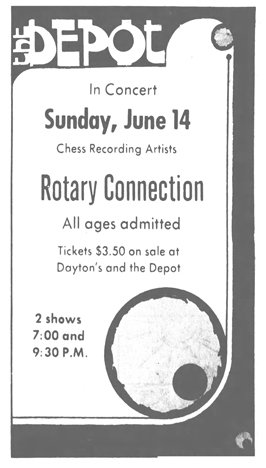
Minneapolis Star
Reviewer Jim Gillespie, a student at the U, reported that the seven-piece group with two lead singers had an instant rapport with the audience. Apparently the world was not aware of the charms of Minnie Ripperton: “Most of the time the girl sang along in a screamingly high pitched voice, at times creating the effect some groups obtain by using an electronic instrument called the theremin. Her range was amazing and she added much to the total sound of the music.” Songs performed included:
- Sunshine of Your Love
- Ruby Tuesday
- Stormy Monday Blues
- Soul Man
Gillespie was impressed with local band Thundertree, remarking that they were better in person than on their record, they played several interesting original songs, and their version of “16 Tons” was “really stunning.”
In the Insider, Will Shapira’s review noted that Ripperton’s voice was “super-shrill” last year at the Labor Temple, but that it had improved its sound and were much more musical, listenable, and professional. Minnie’s two-year-old son Marc impressed Shapira with his drumming and high-fiving skills.
June 20, 1970, Connie’s Insider:
Allan Fingerhut, owner of the Depot, has had some wild scenes running this big, new club in downtown Minneapolis. For instance, it cost him $5,000.00 out of his pocket to pay off the Cocker people on opening night because the club’s booker, no longer the club’s booker, misrepresented the gross potential of The Depot to Cocker’s management. Had Allan known this, he never would have agreed to the contract.
The Depot has NO cover charge during the week or on Saturdays. Only cover is charged on Sundays when a national act is on stage, and then it’s a minimum.
The Depot is making an all-out effort to fill the music gap created when the Labor Temple rock series ran into financial troubles and was forced to close a few weeks back.
On May 31, The Depot launched its “open” concert series by presenting Jethro Tull and Clouds in a pair of concerts. An open concert simply means that people under 21 are admitted and only soft drinks are served to comply with the liquor laws.
The price, by the way, was $5 a head and in this super-aware city which launched a boycott of the Crosby-Stills thing and its $10 top, acceptance meant a lot.
No-alcohol Sundays turned out to be the most popular nights, especially since the Labor Temple closed. These were the nights that nationally-known rock groups were brought in, with tickets selling for as much as $6.
June 21, 1970: Alice Cooper, opened by Suite Charity?
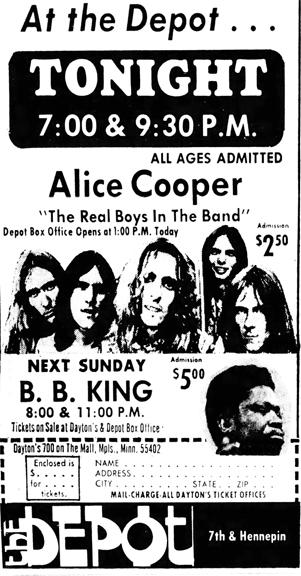
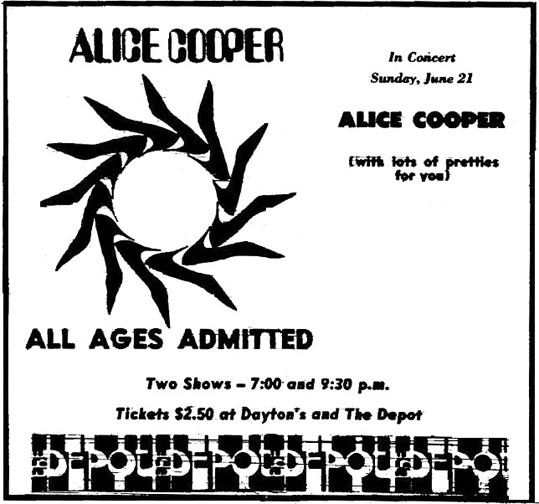
Image from Minnesota Daily courtesy Robb Henry
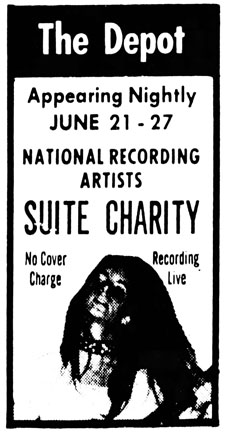
June 21, 1970
June 28, 1970: B.B. King, opened by Lazy Bill Lucas and Mojo Buford’s Blues Band. Crockett, local/house band, may have also been an opening act.

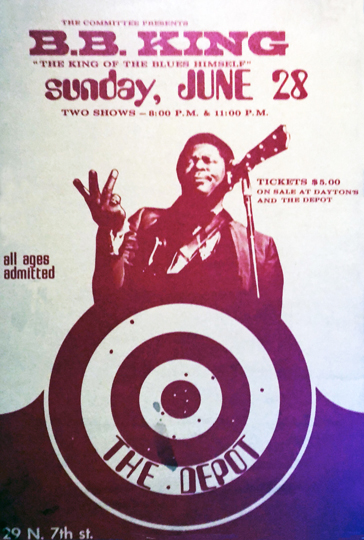
From the collection of Mark Freiseis
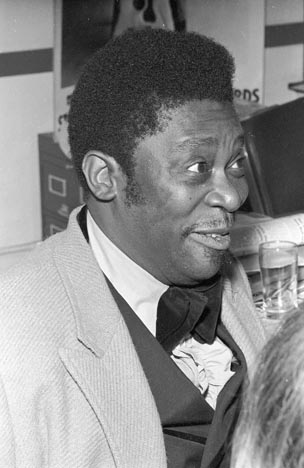
Photo copyright Mike Barich, St. Paul
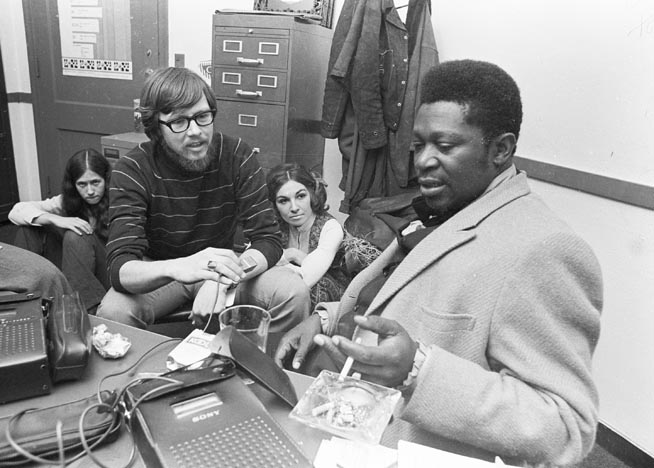
KQRS Disc Jockey Alan Stone interviewing B.B. King. Photo copyright Mike Barich, St. Paul
Jim Gillespie’s review of B.B. King in the Star is worth repeating in full:
The Depot was a blues freak’s paradise Sunday night as it presented three fine acts including the incomparable “crown king of the blues, the man himself, B.B. King.” And B.B. is the King, make no mistake about it.
Lazy Bill Lucas, a transplanted Chicago blues pianist now living in town, opened the concert with a short set of traditional songs in his old-time boogie woogie style.
Mojo Buford’s Blues Band then took over and played a fast-paced set of city blues like “Five Long Years” and “Messin’ With the Kids.” Mojo’s harp playing was fine, as usual, and his new back-up group, while sounding a little ragged in spots, was more than adequate.
Then came B.B.’s back-up band, Sonny Freeman and the Unusuals. The band is made up of two saxophonists, a bassist, drummer, pianist and trumpeter. They opened with a heavily jazz-flavored instrumental which featured solos by everyone in the group. Then the King walked on stage to appreciative applause and yells from the near-capacity audience.
With the first knife-sharp notes wrenched from his guitar, it was clear that we were in the presence of one of the masters. King can wring more emotion out of those six metal strings than practically anybody else in the world and that includes his big-name disciples like Mike Bloomfield and Eric Clapton. It’s all the more impressive when you realize that he invented this style almost single-handedly, more than 20 years ago.
But King’s talent is not limited to the guitar. He is also one of the finest blues singers alive, with a powerful voice and a range that extends all the way from a low-down growl to an exquisite falsetto imitation of a woman telling off her man.
The Depot is not the warmest house in the area but King’s amazing stage presence, fine sense of humor and consummate musical ability transformed it into an intimate, friendly place overflowing with good vibes.
A lot of performers don’t seem at their best in Minneapolis because they can get away with playing a sloppy set and still receive the obligatory standing ovation.
But King is one of the finest showmen in the business and he works hard to make sure everyone has a good time. And they did, too. The next time B.B. comes to town, be sure not to miss him. It’s a are and pleasurable experience.
Memories from Robb Henry:
I was playing guitar with Mojo Buford in 1970 and we were fortunate enough to be the opening act on this show at the Depot. We got to meet B.B. King and hang out a bit in the upstairs dressing room. I was 17 at the time and really impressed by how nice and friendly he was. He was one of the few guitar players that ever sent a shiver down my spine with one note, that vibrato.
When we were hanging out at the Depot, there was a woman in the dressing room and B.B. couldn’t recall her name so he discreetly told his valet to introduce himself to her so he could hear her name again. Dick Garrison and I got a big kick out of that slick little scenario. Etiquette lesson from the King.
Sharron Fingerhut Grohoski remembered that Mr. King was in awe of the scene and humbled at the adolation he received.
Will Agar:
I still remember that evening at the Depot when, half way through his show, [King] took an intermission in the second floor dressing room. There as a knock on the door and a man came in with a suitcase. He opened it and it was full of cash-payment for the evening’s work and insurance that B.B. would finish the second half of his performance!
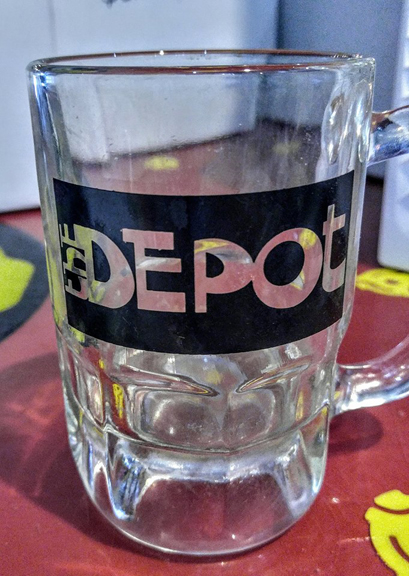
Image courtesy of the Minnesota Music Museum
July 19, 1970: Blodwyn Pig, a British group
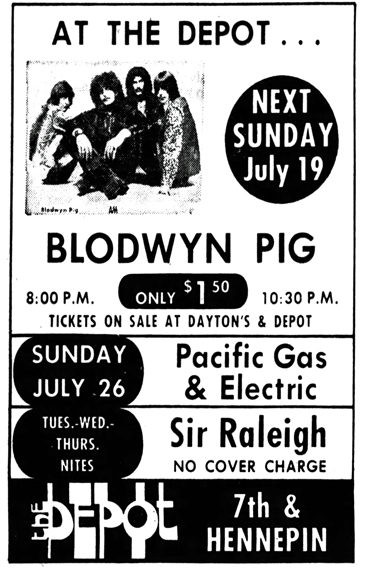
Always kvetching about ticket prices, Hundred Flowers announced that “the Depot is trying its damndest to relate to the community Sunday night by down-pricing tickets to $1.50 for Blodwyn Pig. Blodwyn Pig probably has the ugliest album covers in the world but there’s a lot of beauty between those covers. Mick Abrahams is the leader and former lead guitar for Jethro Tull.”
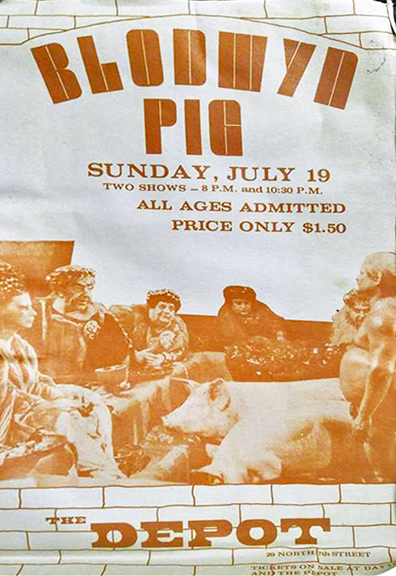
Courtesy John Kass
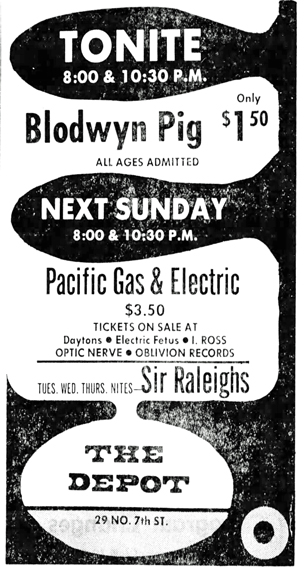
July 26, 1970: Pacific Gas & Electric. This was the group’s fourth visit to the Twin Cities, and much of the personnel had changed.
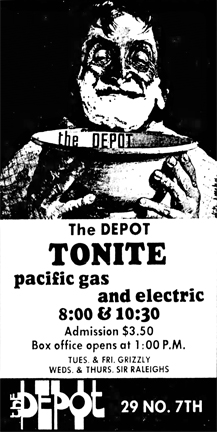
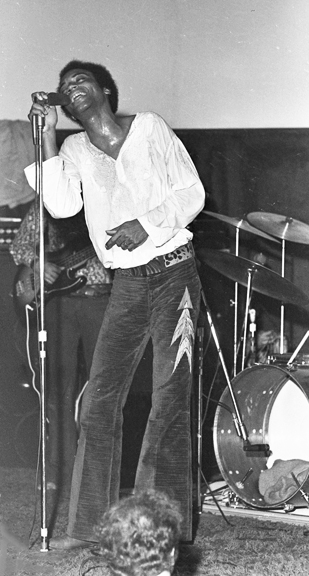
Charlie Allen of PG&E. Photo copyright Mike Barich, St. Paul
Will Shapira reviewed the show for the Insider, and reported “two sizzling sets of blues and boogies.” Personnel included:
- Charlie Allen, lead singer (original member)
- Ken Utterbach, lead guitar
- Ron Woods, drums
- Frank Petricca, bass
- Brent Block, rhythm guitar (original member)
Shapira also reported two “bummers” that night. The first was a female Jesus freak who dragged everybody down with a hysterical harangue just before the second set. The second was a cop who manhanded a kid whose dancing displeased him. Charlie Allen stopped singing, told the cop to let the kid go, Charlie resumed singing, the kid resumed dancing “and everybody got it on again.” (Insider, August 29 – September 12, 1970)
Mike Barich’s photo below shows the enthusiastic (and shirtless) patron in the throes of ecstacy.
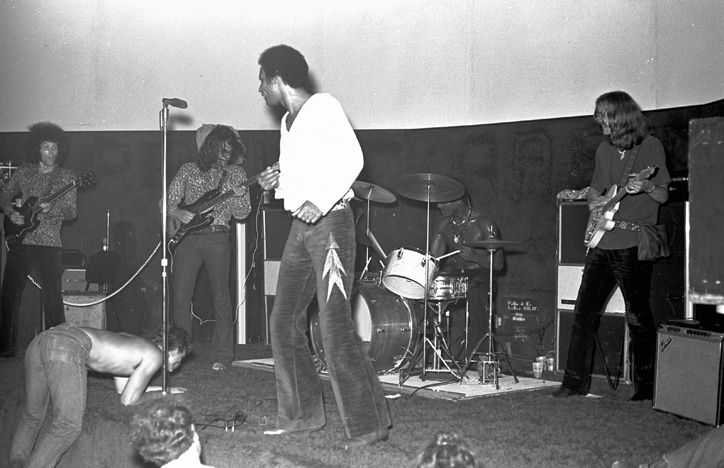
Photo copyright Mike Barich, St. Paul
According to Hundred Flowers, the group “didn’t play anything familiar – not even their new single, ‘Are You Ready.’ Their format is free and fast with lots of improvising, blues cliches, and revolutionary commentary.”
Maybe the reviewer from Hundred Flowers left early, because according to Dodd Lamberton’s review, “Are You Ready,” the group’s one hit wonder, was the last song in the first show, and the only one that was worthwhile. More from Lamberton, a music student at the U at the time:
PG&E’s music is mostly fast, driving blues, which can be an exciting idiom. Rock musicians rave about the magic quality of the blues that makes it so great to listen to and to play. But if the performers do not control themselves, numbers can stretch into 20-minute studies in boredom, with drawn-out solos by each member of the band… The group was capable of much more than it produced and the crowd knew it.
The opening band was Wagner and Little, a four-piece group from Chicago that had been playing together for only a week.
July 28-29, 1970: Al Jarreau. July 28 opened by Grizzly; July 29 opened by the Sir Raleighs. Grizzly was formerly known as Albert Hall, and the Sir Raleighs became Copperhead. (Keep up!)

July 30, 1970: Sir Raleighs
July 31, 1970: Grizzly – “The Funky Stars of the Pan-Am Rock Festival,” read an ad the day before!
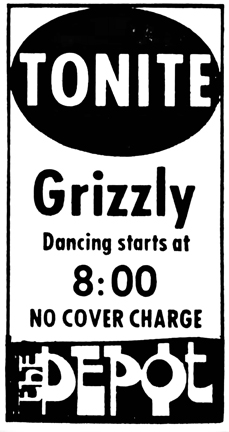
Minneapolis Star, July 31, 1970
August 2, 1970: Benefit for the Minnesota Eight and North Country Freedom Camp.
Tom Utne in the August 7, 1970, issue of Hundred Flowers said that bands included:
- Hundred Flowers Surfjazz Band Orchestra
- Jave, with Greg Gilmer and Rocky Melina
- Betty Boop
- Spider John Koerner
- Bamboo (Dave Ray, Donicht, Animal, and Animal’s little brother)
- Jam by Bamboo and Friends: Maurice, Tommy Ray, John Beach
The ever-irreverent HF reported that Danny Stevens
digs the scene and suggests more at the Depot, where only biweekly shows are planned for the fall. Allen Fingerhut, however, was quite pissed, does not like us not having cops at the door. Does not like twelve year olds smoking dope in his bar, and does not like our admittedly irresponsible planning. Sincerely Apologies Allen. Let’s do it again, okay?
August 16, 1970: Exuma, opened by Zarathustra (first show) and White Lightning (second show)

The Trib’s Mike Steele attempted to prepare Minneapolis for Exuma, nee Tony McKay, a/k/a the Obeah Man, in an article on August 9, 1970. Steele described him as
a strange mixture combining heavy, primitive rhythms, ecstatic use of drums, a pulsing Caribbean beat, electric instruments, and a rock vocal presentation that soon becomes primitive chants.
Exuma is originally from Cat Island, Bahamas, but he came to Greenwich Village in 1961. His first album was overseen by his friend and producer, Daddy Ya Ya, with backing by the Junk Band. …
Exuma denies a connection with voodoo, but many claim that the connection is there. Exuma says only that he writes his music during seances. His lyrics are heavy on zombies, dead men, ghosts, devils and angels.
It all sounds weird, but otherwise serious men who have spoken to Exuma believe it all. His record is curiously successful. His first live appearance here should be one of the more interesting events of the year.
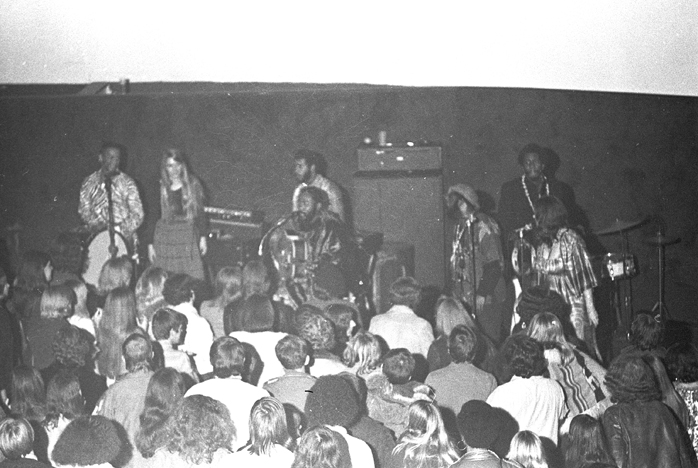
Exuma photo copyright Mike Barich, St. Paul
Reviewer Dodd Lamberton described the band as a group that defies description.
Their music brings together primitive chants, moaning and wailing, and a large variety of rhythms and instruments, including a bass drum, congo drums, whistles, bells and tamborines. It has a refreshing freedom to it, as the members of the group do not seem to have prescribed notes to sing and play – each performance is different. Exuma sings the verses of each song and the rest of the group joins in on the choruses. … In both shows, they had the standing-room-only crowd clapping and dancing to the catchy Caribbean beat. “Obeah Man,” their best-known song, was their best offering.
Will Shapira’s review for the Insider expressed disappointment in the live performance in comparison to Exuma’s first record. He explains,
What goes on in a typical Exuma set is a series of exhortations and incantations to the dark gods of the nether world, shrieked and wailed by the hoarse-voiced Exuma over pulsating Afro-Cuban rhythms. It CAN get pretty exciting at times, but not often enough, I’m afraid. (Insider, August 29 – September 12, 1970)
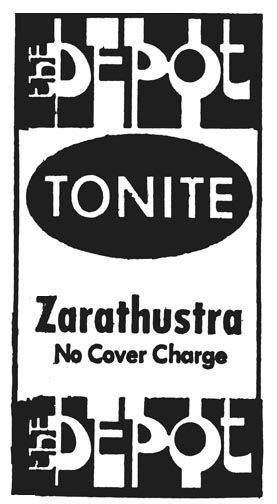
Both Lamberton and Shapira had great things to say about local band Zarathustra, which was booked through August 21. Lamberton called the band “outstanding,” saying that Dick Hedlund on bass, Rick Dworsky on organ and Bobby Schnitzer on guitar are “unparalleled on the local scene.” Shapira said “There was excellent vocal, lead guitar and mouth harp work throughout the set and outstanding arrangement of a song called “White Bird.” It’s a Beautiful Zarathustra!
Don’t know what happened to Crabby Appleton. Maybe they had to “Go Back” to Los Angeles.
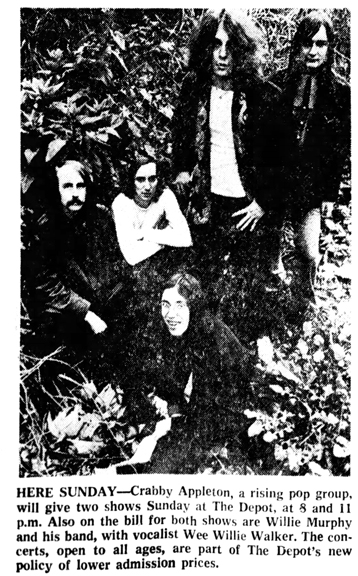
August 30, 1970: Mason Proffit, opened by Willie Murphy. This was a last-minute substitution for Crabby Appleton, which had been advertised just four days beforehand.
Reviewer Dodd Lamberton referred to Mason Proffit as the group that “saved” the Iron Butterfly concert at the Minneapolis Auditorium a few months back. Here at the Depot, “they really turned on the crowds with their smooth, country-western sound.” Unique aspects of the group were that they tuned their instruments one-half step higher than normal, and they used a dobro as a kind of fourth voice.
Lamberton also commented on the opening act:
Willie Murphy and his band made up for their disorganized appearance at the Guthrie two weeks ago with two acceptable sets of mostly original songs. Of these the best was Murphy’s “Eyes of Temptation.” The group’s sound resembled that of the original Electric Flag on the blues tunes.
And as for the Depot’s light show, Lamberton thought it was “as imaginative and as effective as any local show seen recently.”
September 13, 1970: Gathering at the Depot
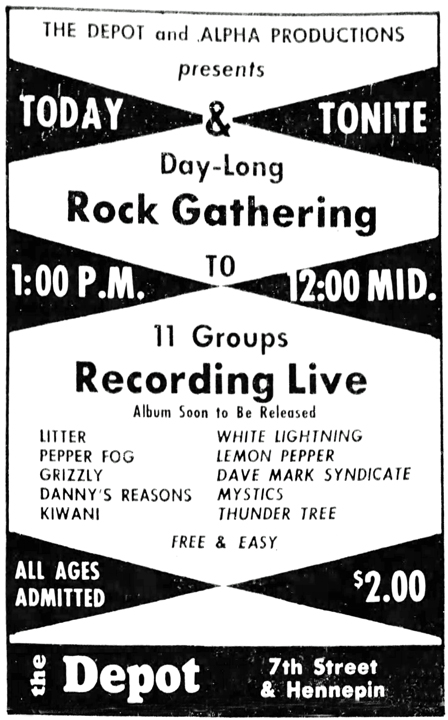
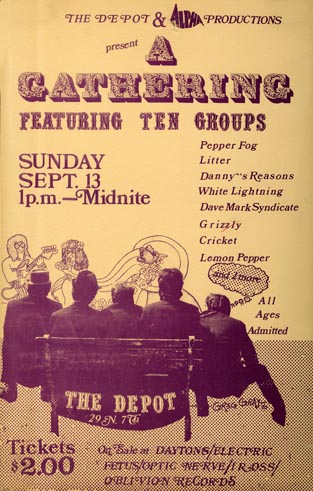
Poster from the collection of Mark Freiseis
ALPHA PRODUCTIONS
The Gathering was a day-long event that resulted in one of the Twin Cities most sought-after albums. All of the bands were clients of Alpha Productions, and was organized by Ralph Ortiz, the head of the agency, to showcase the clients in his stable. It was originally seen as a promotional item, to be sold at the shows of the bands on the record. If a school booked one of the bands, it could sell the records at $1 profit each. The liner notes say that 1,400 people stopped by the Depot that day to hear some of the best bands in the area. Eleven of these bands appeared on the album, although more played that day.
PRODUCER
The Producer of the album was Frank Marino. For you equipment buffs, Frank reported that the recording was made with Scully 8 track equipment and the mastering was done on a computer-controlled Neuman VMS 70 Mastering System (the first of its kind in the country). Amplifiers were provided by Suburban Music Center in Burnsville.
MUSIC COORDINATOR
Jeanette Arithson was a 21-year old booking agent for Alpha Productions.
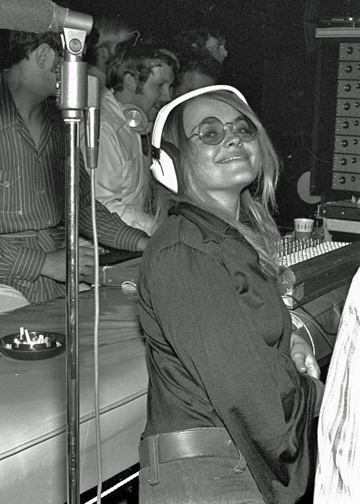
Photo copyright Mike Barich
LOCATION RECORDING
Recording was done by Sound 80, engineered by Sound 80’s Chief Recording Engineer, Tom Jung.
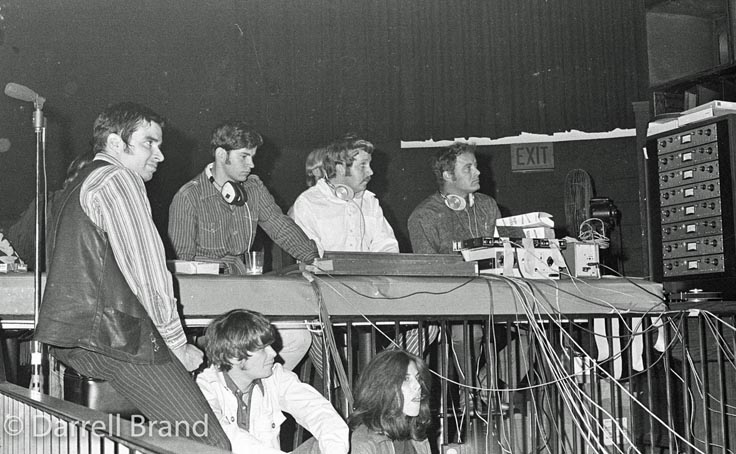
Photo of Sound 80 staff copyright Darrell Brand
ARTWORK
The front and back artwork was done by photographer Darrell Brand.
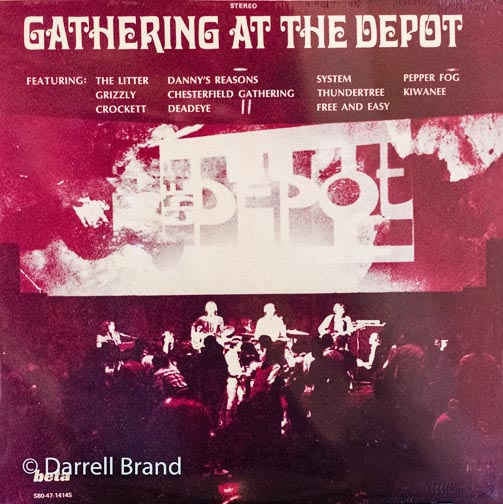
Album cover copyright Darrell Brand. Danny’s Reasons is featured.
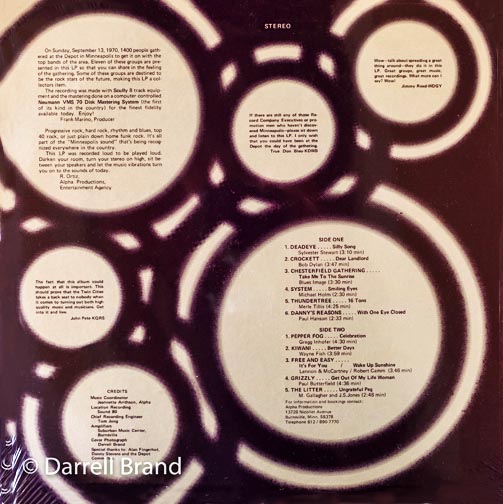
Album back copyright Darrell Brand
In addition to the people above, special thanks were given to Alan Fingerhut and Danny Stevens of the Depot.
THE JOCKS
Given the number of disk jockeys in attendance from the big rock stations, it was the place to be. That big honkin’ microphone in the photo below suggests that they might have been doing a remote broadcast as well.
Endorsements were provided on the album by John Pete of KQRS, True Don Bleu of KDWB, and Jimmy Reed of WDGY. All were the top Disc Jockeys of their stations.
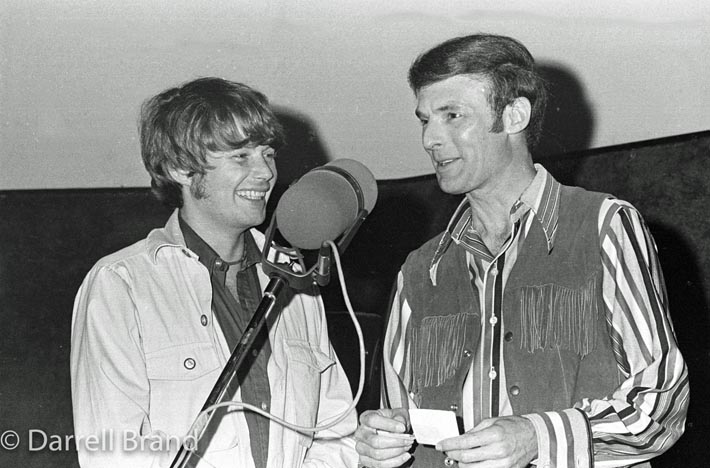
John Pete, KQRS, and Jimmy Reed, WDGY. Photo copyright Darrell Brand
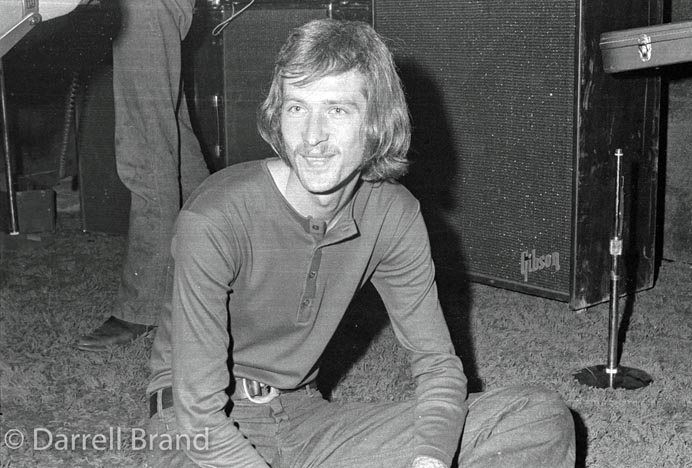
True Don Bleu, KDWB. Photo copyright Darrell Brand
THE BANDS
The participating bands varied between those listed on the poster and those that appeared on the resulting album. These are not in the order of the album but start with ones I have pictures for.
Pepper Fog: On poster and album (“Celebration”, written by Gregg Inhofer)
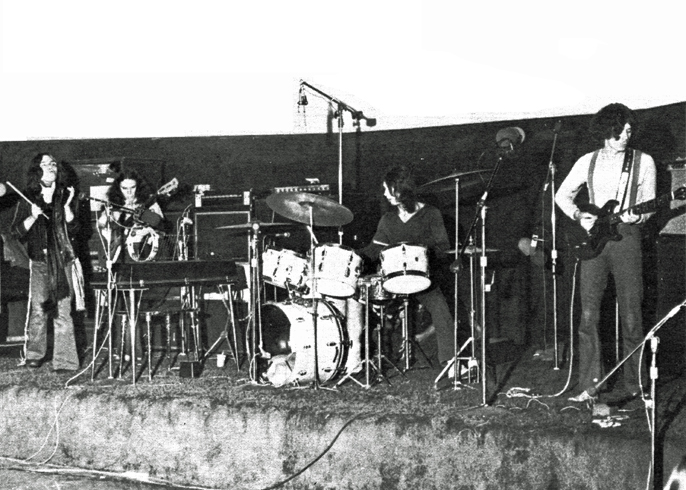
Pepper Fog photo copyright Mike Barich
The Litter: On poster and album (“Ungrateful Peg,” written by M. Gallagher and J.S. Jones)
A note from the Litter’s drummer Tom Murray in 2020:
“Ungrateful Pig” was the title of our original song that The Litter recorded for that album. When it was released, the title was changed without The Litter’s permission to “Ungrateful Peg!!” It was wrong for whoever made that decision to change a copyrighted song title to their title that they wanted for the album!! It still irritates me today for what they did!
But the “Gathering at the Depot” album, with all the bands that were on this record, is a great tribute to Minnesota’s music Royalty! Proud I was a part of it!
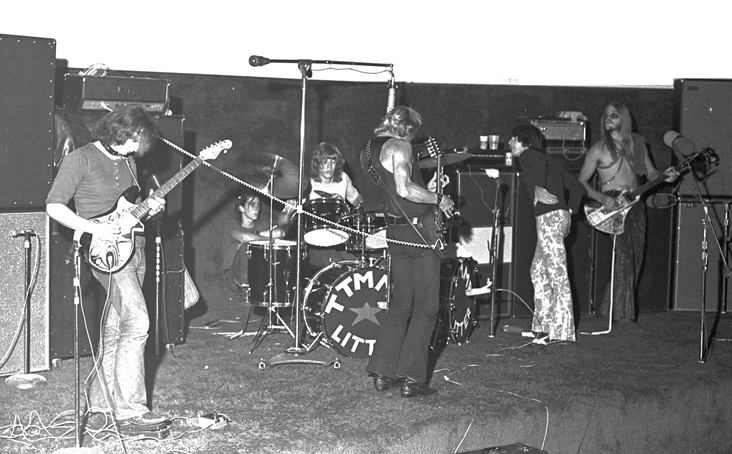
The Litter at the Gathering. Photo copyright Mike Barich
Crockett: On album only (“Dear Landlord,” written by Bob Dylan)
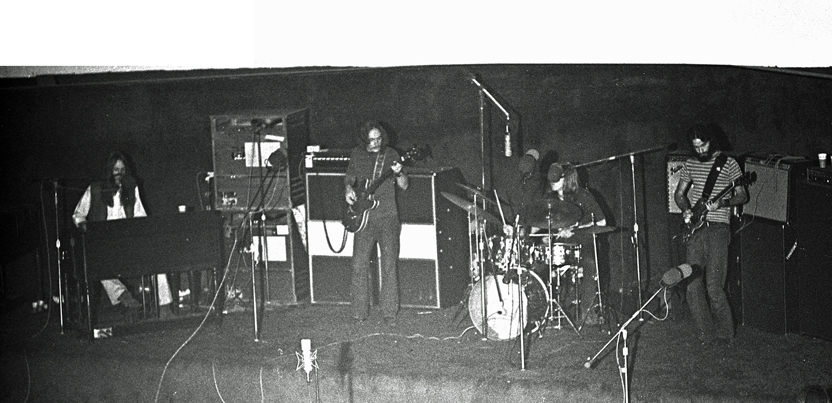
Crockett at the Gathering. Photo copyright Mike Barich
Thundertree: On album only (“16 Tons,” written by Merle Tillis)
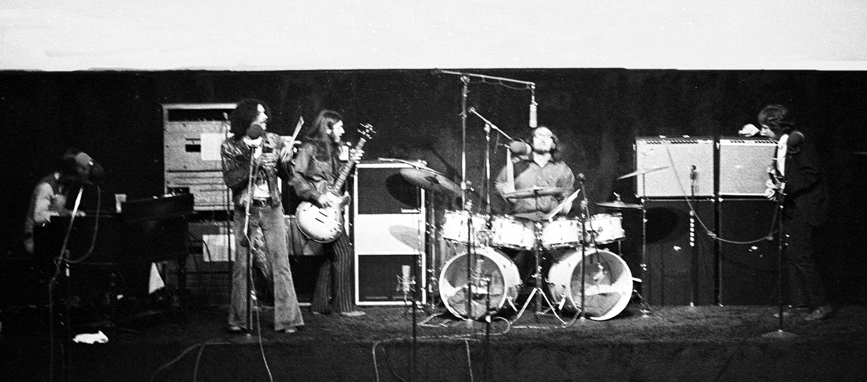
Thundertree at the Gathering. Photo copyright Darrell Brand
Free and Easy: On album only (“It’s for You” (written by Lennon & McCartney) / “Wake up Sunshine,” written by Robert Camm ). Original members pictured below were, left to right, Tom Behr,Tony Tuccitto, Pat Dee, Dave Vigoren, Tom Mulkern and (unseen in the back), Bobby Gomez on drums.
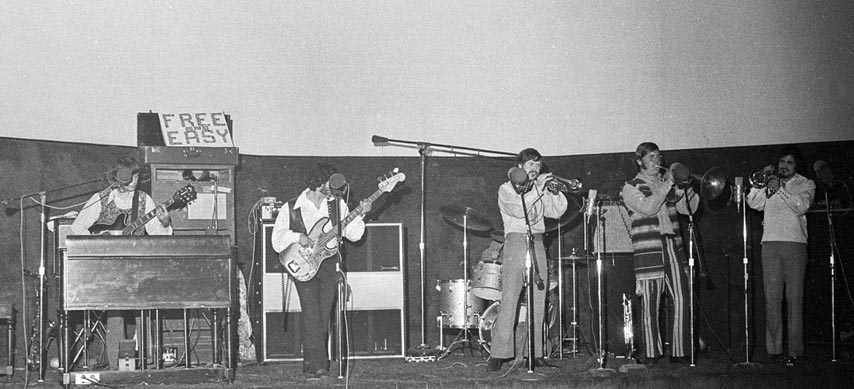
Photo of Free and Easy at the Gathering copyright Darrell Brand
White Lightning was on the poster but their performance didn’t make it to the album.
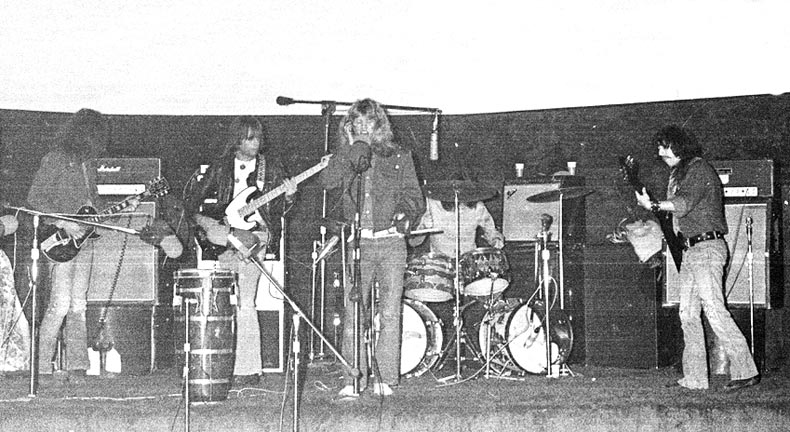
White Lightning at the Gathering. Photo copyright Darrell Brand
- Danny’s Reasons: On poster and album (“With One Eye Closed,” written by Paul Hanson)
- Grizzly: On poster and album (“Get Out of my Life Woman,” written by Paul Butterfield)
- Deadeye: On album only (“Silly Song,” written by Sylvester Stewart)
- Chesterfield Gathering: On album only (“Take Me to the Sunrise,” written by Blues Image)
- System: On album only (“Smiling Eyes,” written by Michael Holm)
- Kiwani: On album only (“Better Days,” written by Wayne Fish)
- Cricket: On poster only. Cricket had been a horn band, but got bumped when they lost their horns, according to Tim Emerson.
- Lemon Pepper: On poster only
- Dave Mark Syndicate: On poster only
SAD NEWS
I’ve had an email from Ralph Ortiz’s daughter, who says that after hauling them around from move to move after her father died, she ended up tossing several boxes of these precious albums away! I paid an arm and a leg for mine! I just noticed that the sleeve on mine had the previous owner’s song reviews on it. One thing he did say was that “This baby got touched up big time in studio.”
BUT ENJOY!
Nevertheless, find one of these if you can, and follow Ralph’s advice:
Progressive Rock, hard rock, rhythm and blues, top 40 rock, or just plain down home funk rock. It’s all part of the “Minneapolis sound” that’s being recognized everywhere in the country. This LP was recorded loud to be played loud. Darken your room, turn your streo on high, sit between your speakers and let the music vibrations turn you on to the sounds of today.
September 27, 1970: The Illusion, opened by Jarreau and Zarathustra.
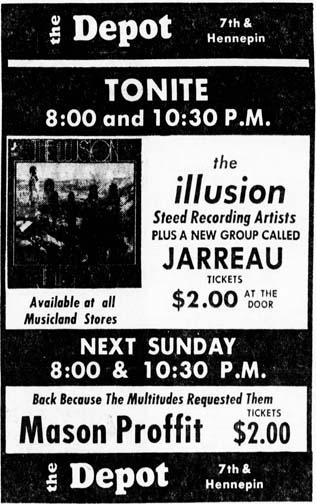
Minneapolis Tribune, September 27, 1970
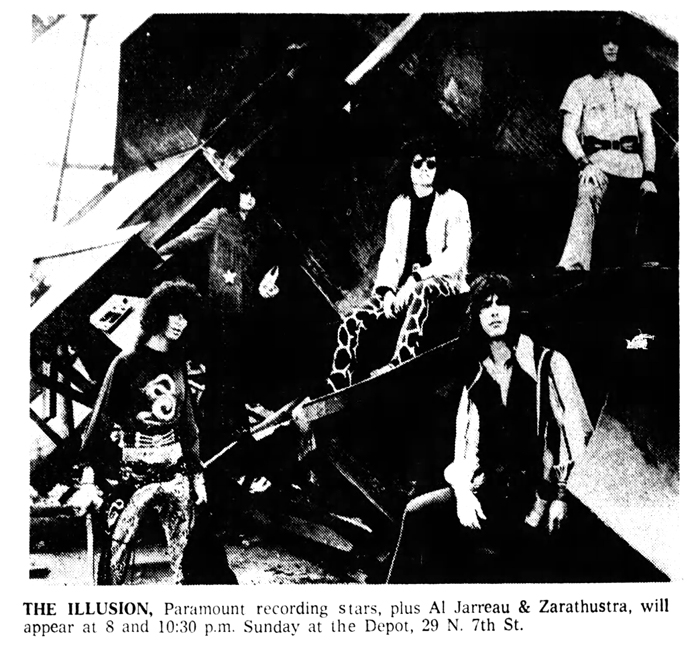
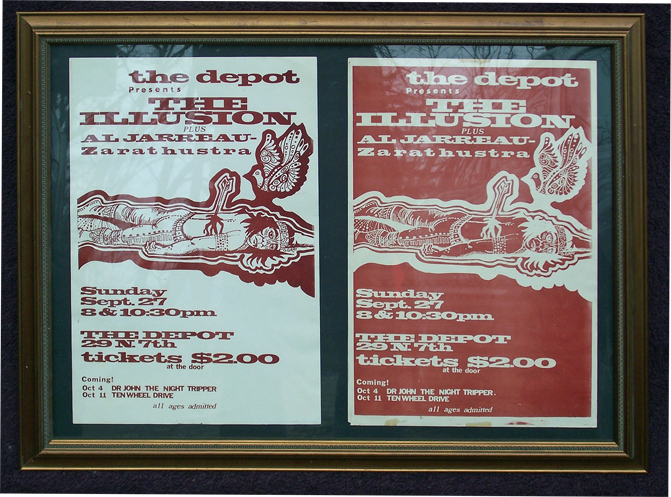
Posters from the collection of Mark Freiseis
The Illusion was a psychedelic hard rock band from Long Island. In a news blurb they were described as a five man, up-and-coming rock band with two records out on Paramount. In all, they released three full-length albums in the U.S., produced by Jeff Barry. Their only hit here was “Did You See Her Eyes.”
Read about the band Jarreau here.
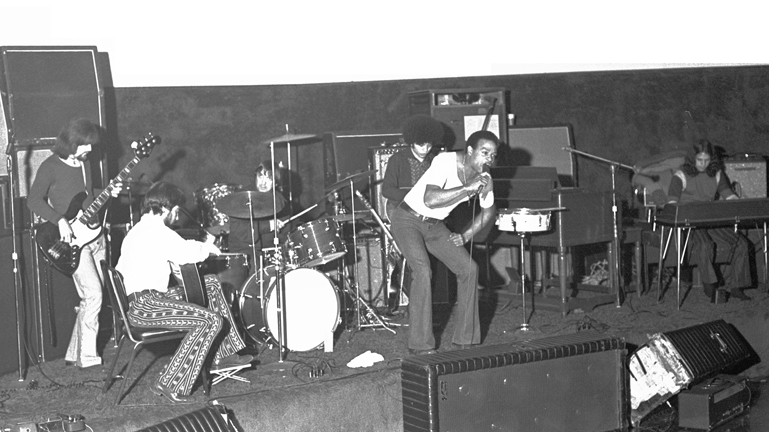
Jarreau photo copyright Mike Barich, St. Paul
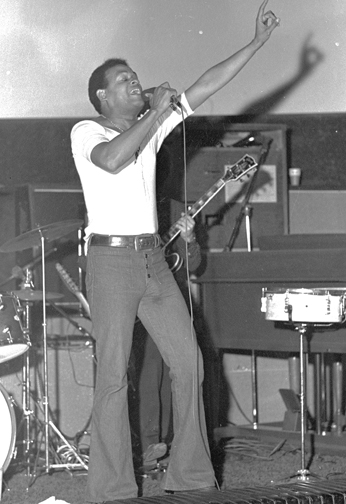
Al Jarreau photo copyright Mike Barich, St. Paul
October 4, 1970: Mason Proffit – “Back Because the Multitudes Requested Them.” Opened by Enoch Smoky.
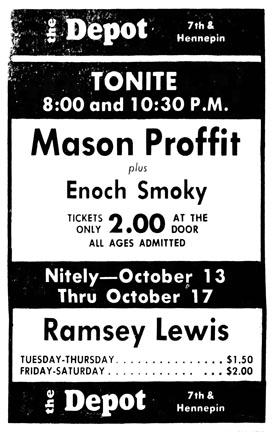
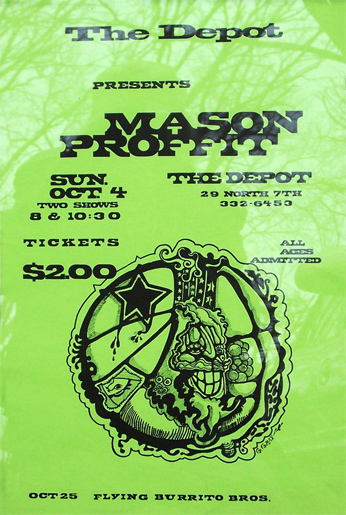
Poster from the collection of Mark Freiseis
October 13 – 17, 1970: Ramsey Lewis Trio – two shows nightly
October 23, 19270: Del Counts
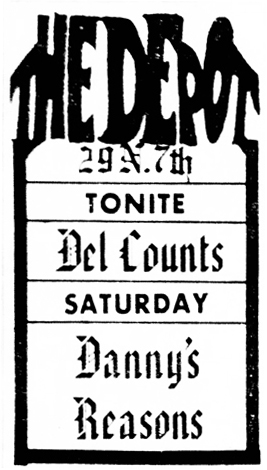
October 24, 1970: Danny’s Reasons
October 25, 1970: Frank Zappa and the Mothers of Invention and the Flying Burrito Brothers, opened by local/house band Crockett.

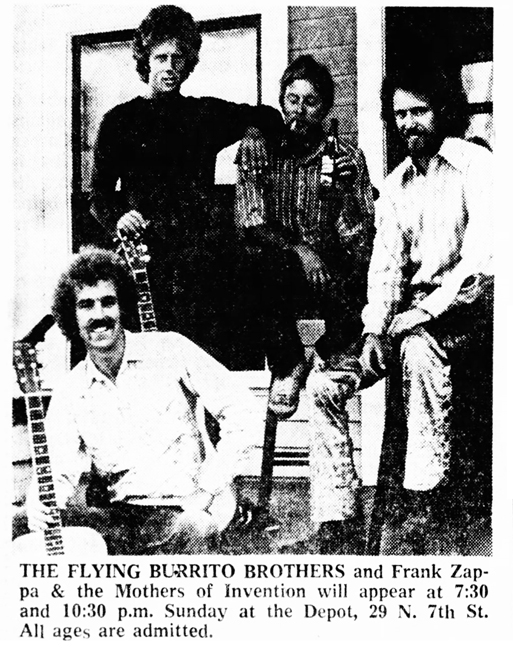
Minneapolis Star
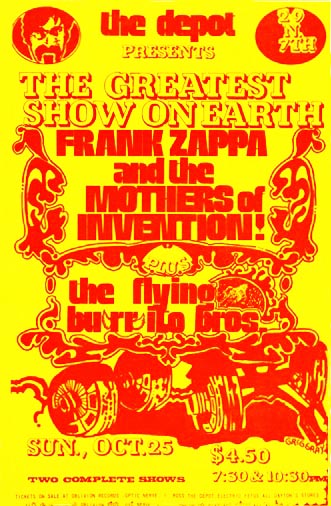
Poster by Greg Gray from the collection of Mark Freiseis
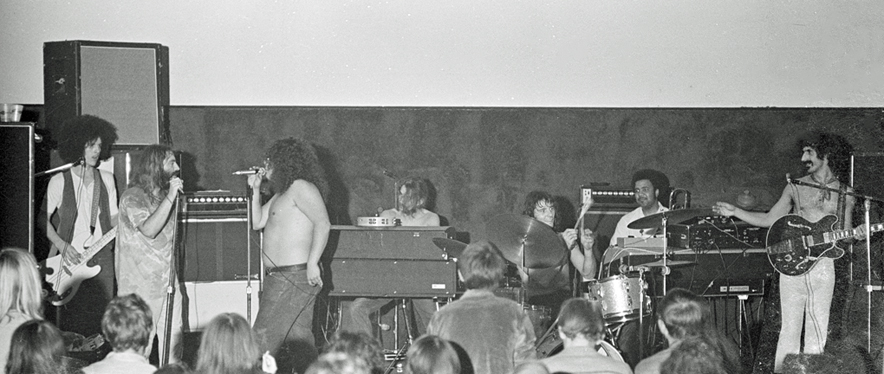
Photo copyright Mike Barich, St. Paul
What a scene! 1,500 people jammed the Depot for each of two shows.
Hundred Flowers reported that the Flying Burrito Brothers opened, minus Gram Parsons but with pedal steel guitarist Sneaky Pete, Barry Lieden, Rick Richards, and Chris Hillman, the only former Byrd in the group by this time.
The Star’s Peter Altman found the country-rock band to be attractive and well-balanced but “without quite enough personality and fire.” They played bluegrass breakdowns, old hits like “Hand Jive,,” Byrds’ favorites like “One Hundred Years from Today,” neo-cowboy ballads and a song about going to Canada to beat the American draft.” They showed “fluency, a variety of styles, and recalled many eras and personalities. There was an inescapable derivativeness about much of the groups music, however, and a consistent failure to come up with the unexpected.”
Zappa and the Mothers included the Turtles (Flo and Eddie), aka Howard Kaylan (the one with the shirt on) and Mark Volman (the fat one with no shirt on). Hundred Flowers was fixated on Volman, the fat one, apparently often mistaken for Larry Mondello, the fat kid on “Leave it to Beaver.” Volman joined the movement to petition KMSP to put “Beaver” back on TV. Dr. John the Night Tripper was also there in some capacity.
Altman was not at all impressed with Zappa, at least the short 35-minute first show that he saw. “There were scattered shafts of outrageous insult and vulgarity (which were few but funny), but not much else. Musically the group was content to get by with bang, and there was almost none of the weird, oddly appealing sentimentality which in contrast with so much grossness is the key element in the usual Mothers’ formula. [Only] very isolated glimpses were all that could be seen of the Mothers’ antic invention and power to touch…”
Scott Bartell’s review reveals that the Mothers did three long pieces, the first two of which were “Call on Any Vegetable” and “Duke.” Bartell said that Zappa told the audience that they were the most laid-back group he’d ever seen, and downtown Minneapolis was the most laid-back place he’d ever seen. Was that a compliment or a dig? Later Barthell reiterated that Zappa said this was the most polite and receptive audience he’d played for.
November 1, 1970: Don Ellis and 23 Friends, opened by Dean Granros, Jazz composer and guitarist from Minnesota.
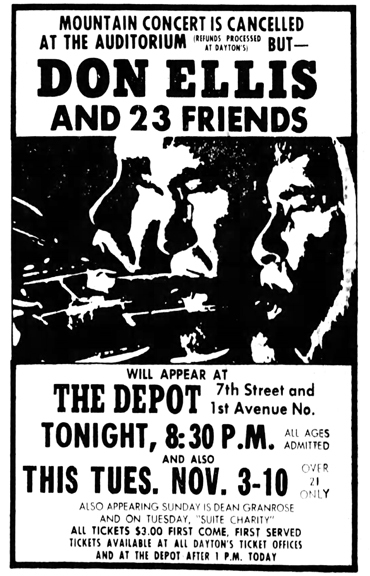
Reviewer Marshall Fine called this “one of the brassiest, most exciting concerts Minneapolis has seen in a long time.” The gig happened because the group Mountain was supposed to perform on October 31, 1970, at the Minneapolis Auditorium, with Ellis as warmup. Leslie West of Mountain fell ill and couldn’t perform, so that concert was cancelled and Ellis was booked into the Depot.
Fine described the group as a “killer band, specializing in polyrythmic swing.” Ellis, “a grinning madman,” played the trumpet and directed the band “with the savagery of a samurai warrior and with the abandon of a man completely married to his work.” Clarinetist Sam Falzone played something called “The Bulgarian Bulge” in 33-16 time. “I mean, nobody plays that fast,” mused Fine. Ellis used something called the Condor, a device that could change the tone and timbre of his trumpet and hook into a tape loop, which allowed Ellis to play a duet with himself.
Will Shapira reviewed the show for the Insider, and called it “one of the most exciting evenings of music we’ve laid on our heads lately.” For the most part the band performed its new album, “Don Ellis at the Fillmore,” and he “tore the roof off the Depot and completely knocked out the audience.” Compared to the live audience on the LP, Shapira opined that the Depot’s crowd was more visceral and “they let it all hang down.”
Ellis and band made an appearance on Bill Carlson’s show “This Must be the Place,” airing on Channel 4 – apparently on December 25, if I’m reading Will Jones’s column of December 27, 1970, correctly. Jones rued that he had missed the live performance at the Depot, and noted that the band had four drummers.
November 3, 1970: Don Ellis and 23 Friends, opened by Suite Charity
One show at 10 pm. See November 1 above.
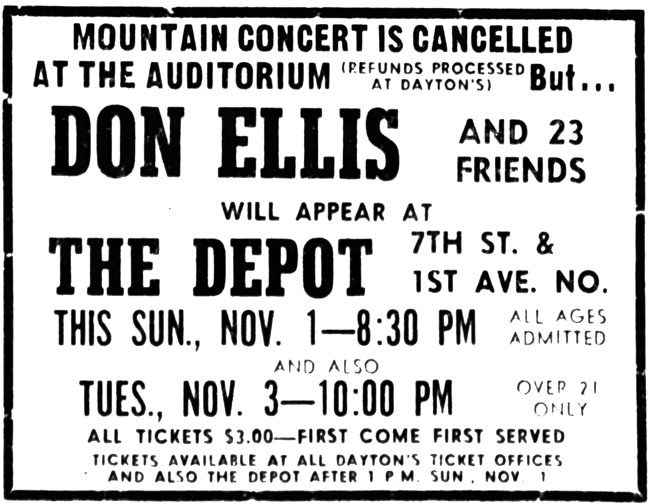
November 8, 1970: Small Faces, featuring Rod Stewart. Opened by local group Downchild.

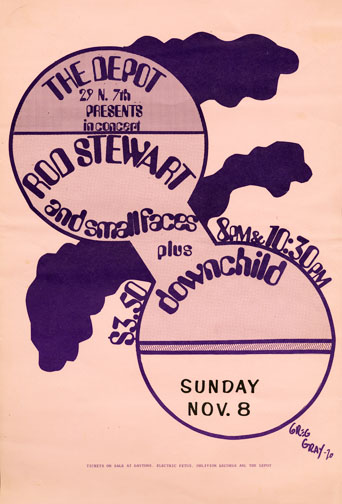
Poster by Greg Gray from the collection of Mark Freiseis. From First Avenue: Minnesota’s Mainroom by Chris Riemenschneider, MNHS Press, 2017
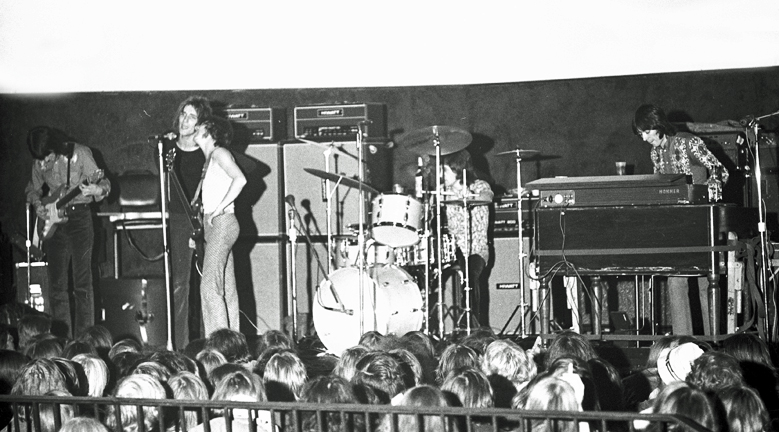
Most of the Small Faces. Photo copyright Mike Barich, St. Paul
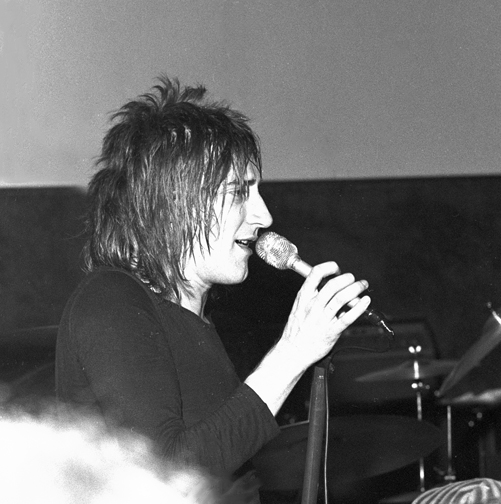
Rod Stewart in 1970. Photo copyright Mike Barich, St. Paul
Pat Marciniak of Hundred Flowers reported that the Small Faces “brought with them a musical sound that’s a big overwhelming combination of musical flowers and colors, along with bright globes of sound. Their concert was thoroughly enjoyable, as was proved by the crowded Depot of fans who cheered with screams and whistles of cries for more.”
The show started late because Ian McLagon’s piano was missing, so the first set only lasted 45 minutes. HF again:
To prove how popular the group really is in the Twin Cities, all anyone wouldn’t had to do was to see the long lines of people standing out in the pouring rain waiting to get into the second show. Only a few had umbrellas, but those who didn’t, didn’t want to move, afraid they might lose their place to see the show.
Scott Bartell’s review in the Strib revealed that it was Early Days for the Faces, and the first show was two-thirds full. Rod Stewart was such a new “face” that Bartell had to describe his voice and approach, which he compared to Joe Cocker, but “minus the worst spastic seizures.” Each song seemed different, with excellent contributions from Ron Wood, Ron Laine, Ian McLagon, and Kenney Jones.
Here’s a story about that concert from Mike Guion:
The Faces were the headliners, and did two shows that night. The second show was to start at 10, but didn’t until after midnight, and despite the late start, the opener did play. By far the most loud show I’ve ever attended, with “Around The Plynth” the highlight, with Woody’s slide shaking the walls. Hard to believe now, but that show did not end until 3 or so. We stood outside in a downpour waiting for the first show to end. Rod had yet to use any hair dye, and the band had to walk from the upstairs dressing room through the crowd to the main floor. Rod’s first solo album was still fresh, and the Faces were touring off their new release called “First Step.” I remember all this so well because I had to be back in downtown at 6 am for my first Army physical. I never got undressed after driving my friends home. Just laid on my bed waiting to take that drive back, wondering if I got drafted where I’d go and what would happen to me. I failed the test. Said I had high blood pressure. I believe the Faces saved my life.
DOWNCHILD
Bartell had a lot to say about Downchild, too, calling them “competent within their tradition (that vast commercial tundra bounded by Blood,Sweat and Tears on the jazzy side and Gary Puckett and the Union Gap on the money side) but they don’t add much to it. I could only listen with half an ear after the first few songs, which gave me time to consider the light show. I considered it pretty dull, though perhaps the groups asked them not to get too flashy. I did like some of the photos of girls, however.”
Jerome Lawrence Beckley of Downchild proudly reports that the band performed all but one original tune. “It was difficult making a living being a concert band doing original material back then.” (The cover tune was Dylan’s “Just Like a Woman.”)
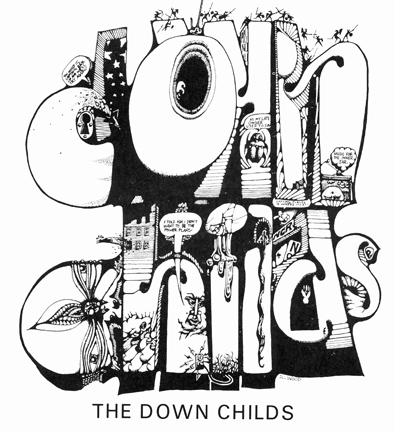
Image from Insider, July 18, 1970
Jerome says that the image above is
part artistic license by my creative friend, David Wood, who created this poster, and Traficante adding our name under the poster design. Our name was fooled with all the time. My favorite was “The Dawn Childs Orchestra.” The name comes from a song by Sonny Boy Williamson, “Mr. Downchild.”
So to be clear, the name of the band was Downchild.
November 15, 1970: Country Joe McDonald (without the Fish). Opened by Wire, a local band featuring Curtiss A (Almstead).
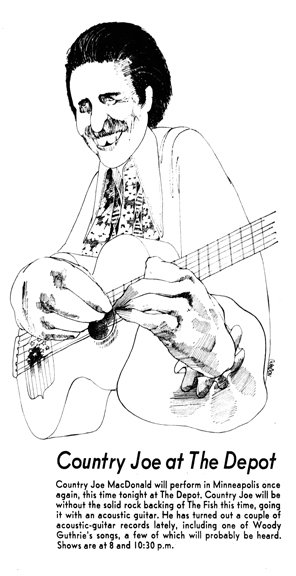

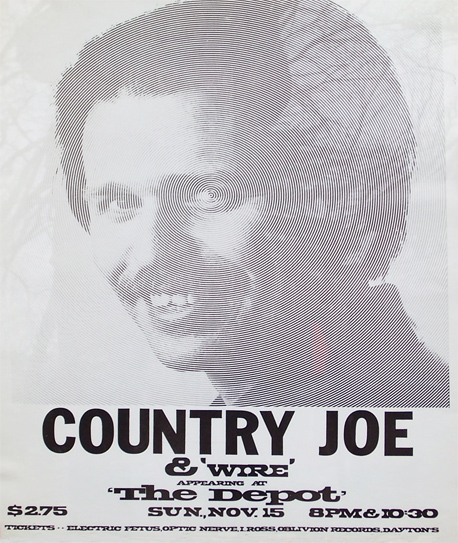
Poster from the collection of Mark Freiseis
Paul Engel of Hundred Flowers reported that
Country Joe performed admirably, what with the unresponsive audience and the plasticity of the Depot on all sides … It was more like playing in a freakily-painted bus station for the cost of a bus ride from Mpls. to St. Cloud. The performance was lively, expertly delivered, and his material was fresh and poignant.
Dodd Lamberton reviewed the show for the Insider, agreeing that the audience was restrained – but appreciative. The solo acoustic show demonstrated changes for the better, opined Lamberton, citing his “soft, straight-toned voice” and clear annunciation. An interesting observation in the review was that McDonald seemed “pensive and depressed, as if he had just lost a friend” when Lamberton talked to him after the show.
A WORD FROM CURTISS A…
Dodd Lamberton’s review in the Insider included these remarks about Wire, known famously as the first band of local legend Curtiss A:
Wire, the preliminary group, did an amalgamation of oldies and current hard rock songs, from the early Chuck Berry to Savoy Brown. Their vocals were excellent, as they have three men who can both solo and blend well.
Years later, in an interview for KSTP Channel 5 news, Curtiss A had this to say about the show and the venue:
If I’m not mistaken, my first connection to the place was through Danny Stevens. He saw our band and thought we had something. We had played at George’s in the Park (in St. Louis Park) as kind of an audition-type gig, and then we wound up there, including playing with Country Joe McDonald.
I remember the sound system there was really good. I was impressed. Even if it wasn’t what I was expecting from a nightclub, having been a kid and watching TV. It wasn’t Ricky Ricardo and the Copacabana, but it was a great place. And the first couple of times there really did feel like big-time showbiz. We got to essentially debut in the biggest and best place in town, right when it was getting started, and I feel lucky about that.
It’s funny thinking about it now, because back then, I had no idea how relatively an important place it would become in my life. It really gave a focus to all the divergent threads you had in the music scene here, and they’ve always been really supportive of local acts. Some places just have national acts in, and that’s fine if you can sustain yourself that way. But I’ve always felt it’s been more interesting to see all the things we’ve had going on in the Twin Cities too.
At the time of the KSTP interview, Curtiss estimated he’d played the club more than 100 times.
AND THIS:
Don Driggs reported on Facebook:
At that time I was Wire’s manager and I booked that show. Curt was the lead singer. I have vivid memories of going on stage during a song and telling Curt that they were playing too long and if they did not quit, they would not be paid. Curt ran off the stage with me in hot pursuit, chasing him into the back interior parking area. I thought I saw him run into Wire’s bus. I followed but he must have gone out the back door and I lost him. I went back on the stage and searched the crowd – I finally saw him standing in the balcony beside Allen Fingerhut, the owner. Lol. Curt has his own great story about those events. Great Memories..I love that band.
November 17-18, 1970: Wayne Cochran and the CC Riders, opened by Suite Charity
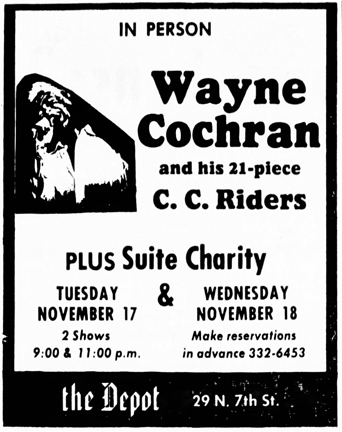
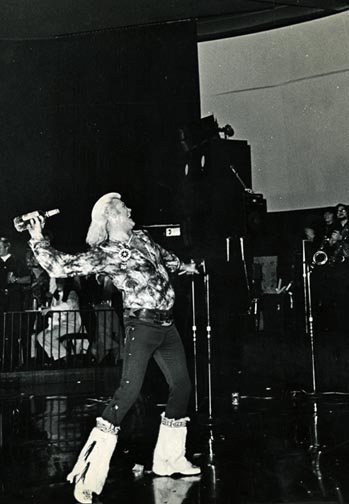
Wayne Cochran, about to throw a bottle. Photo courtesy Sharron Grohoski. From First Avenue: Minnesota’s Mainroom by Chris Riemenschneider, MNHS Press, 2017
According to a couple of reviews in the December 3, 1970, issue of Hundred Flowers, Cochran’s schtick was to be as racist, sexist, and generally insulting as possible to our fair city. And the audience ate it up. (Sharron Fingerhut didn’t remember it that way at all and had the best time!) Cochran came with a 21 piece band and three backup singers.
November 22, 1970: Sweetwater, opened by Wagner Little

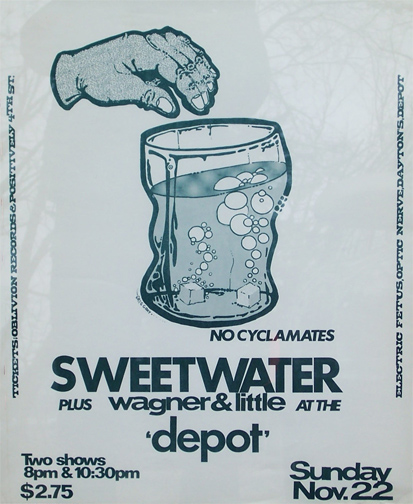
Poster from the collection of Mark Freiseis
Sweetwater’s signature tune, “Motherless Child,” was sung on record by Nansi Nevins, but she was not at this performance. On December 8, 1969, she was severely injured in a car accident, causing brain damage and permanent damage to one of her vocal cords.
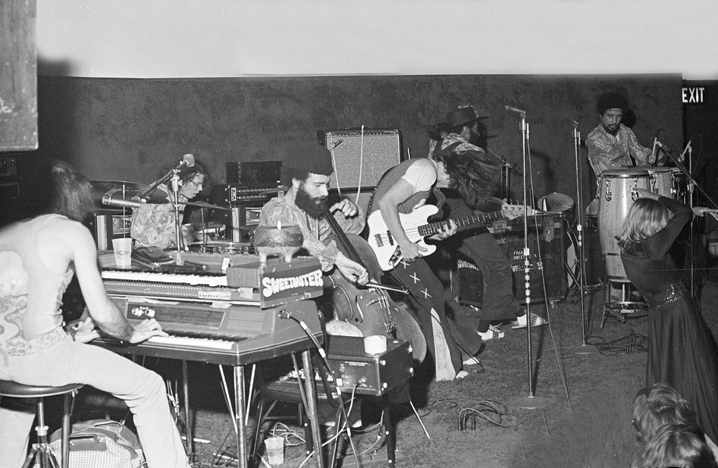
Sweetwater photo copyright Mike Barich, St Paul
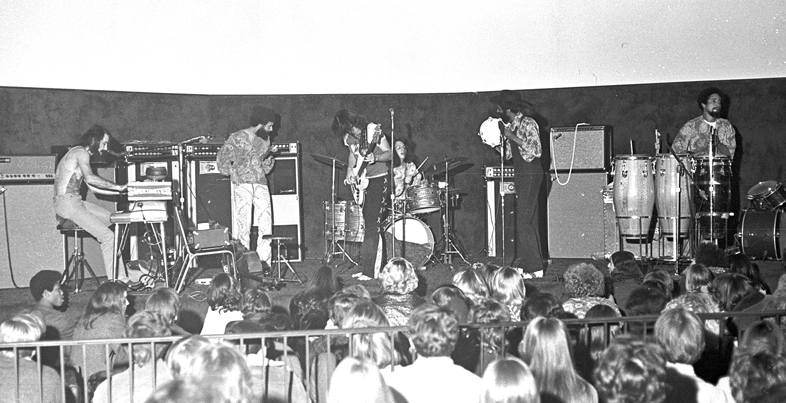
Photo copyright Mike Barich, St. Paul
Reviewer Scott Bartell mourned Nansi’s absence, but deemed the sound of the remaining six members as “rich and compelling, their stage presence relaxed and genial. They only played five songs for their first set, perhaps holding off for a larger crowd. Yet even those five numbers demonstrated the intricate workings between the Afro-Cuban rhythm section, the highly flexible keyboard work of Alex Del Zappo, and the jazz stylings of flutist Albert Moore and cellist August Burns.”
Wagner Little was deemed a creditable warmup group, playing rock, blues, and a little folk. Bartell was unsure about where they came from. He was both amused and maybe annoyed at the “circus tricks” of the drummer, who was very adept at drumstick twirling and hitting snare drums mounted above his head, but deemed a better singer than drummer.
November 25, 1970: Mainstreet, presumably a local band
November 29, 1970: Exuma, with Willie Murphy and the Bumblebees
See August 16, 1970, above for a description of Exuma’s act.
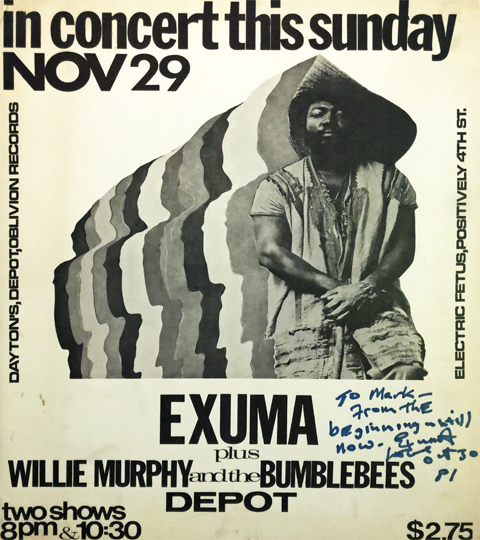
Poster from the collection of Mark Freiseis
December 5, 1970: Ned, one of the house bands.
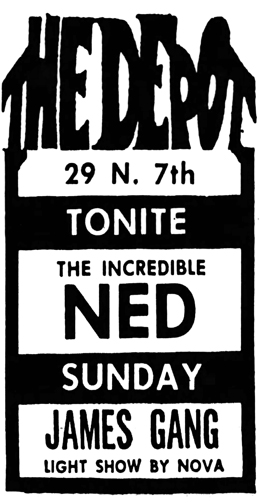
December 5, 1970, Connie’s Insider: Headline: Depot Revisited: Where is the Club Now? Connie published an extended interview with Allan.
The Depot in downtown Minneapolis has the potential of becoming one of the truly great rock palaces of the country. It’s big and it’s smack in the heart of downtown Minneapolis. However, it certainly is not without its problems… big ones, to the surprise of many of our readers who are regular patrons of the club.
The club opened with a bang for Joe Cocker last April, and has steadily lost money up to perhaps, the beginning of fall. The people were coming to hear some of the best rock acts anywhere, but they weren’t spending money; and they still aren’t setting any fiscal records. What many of you don’t realize is that places like the Depot have a big overhead every week, and they have to sell the only thing they can, booze, to pay the rent and the hundred other expenses with which they are regularly faced.
The club’s owner and founder, Allan Fingerhut, emitted his boyish smile as we sat in his office the other night discussing “business at the Depot.”
“Sure we’re getting people in the joint,” he said, as the phone lines rang and people floated in and out of office, as if they were on a tour of the facilities, “but we’re not taking in the kind of money we should be. The people aren’t buying drinks like they should. I still don’t draw a salary. I can’t afford to and still stay in business. We have a super good manager now; he was a miracle for helping us get the club running properly.” As if on cue, Joe Sandino walked into the office and went to the safe to take out an employee’s check. Joe is the Depot’s new manager, and Joe is a heavyweight…he knows how to run a tight club, taking care of business while making sure Allan’s desire that everyone feel welcome and unhassled is fulfilled.
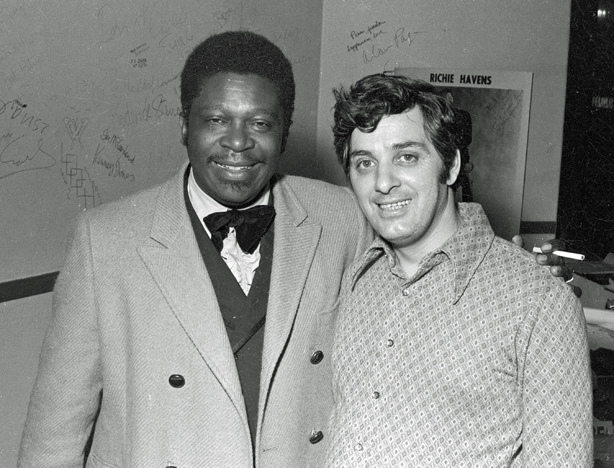
Joe Sandino with B.B. King, June 28, 1970. Photo copyright Mike Barich, St. Paul
“Tuesday, Wednesday and Thursday are still slower than we would like,” Allan continued, but our Fridays, Saturdays and Sundays are big nights. Monday night the joint is packed for our wine and beer feature. (customers can get all the wine and/or beer they can drink for $2.50) We always feature national acts on Sundays, with the best local bands on all other nights.” The same sweet-looking chick came into the office for the third time, looked ‘round, and walked out. “If these people would spend a few bucks, instead of expecting everything we have to offer for free, we’d be ok.” I nodded in agreement.
The club books its local acts through Marsh, Alpha and Central. According to Allen, the Sir Raleighs and the System do perhaps the most business, or have the biggest following.
“What about your partner, Danny Stevens,” I inquired. “Is the Reasons going to play here?” “Sometimes, but only when we need them. Danny doesn’t come ‘round too often as he doesn’t do too much, though he is by title, president of the Depot.” “You mean you don’t see much of your partner,” I asked. “No,” was his reply.
The man who now directs the club’s finances is Ted Dikel (sic), Allan’s brother-in-law. Ted is a sharp money man who works for Allan’s father, but has been sort of loaned out to help his brother-in-law get his quarter-of-a-million investment running smoothly so that some day soon, they may be able to use black ink on the journals. Allan is still the chief everything who still works many, many hours a week.
It is well known among insiders that Allan and his former manager and talent booker, Abby Rosenthal and Skip Goucher, respectively, had their problems. In fact, their differences may come up in court.
“This club will be enormously successful, it is rated with the Fillmore and other major clubs throughout the country,” Allan said, breaking away from his reflections about his relationship with his former associates. “I believe you,” I replied. It does have all the ingredients to be one of the major showhouses in the country.
“We naturally are limited to what we can afford to pay an act,” Allen said, in reply to my question about ticket prices. We don’t ever want to overcharge our customers, so we can only pay about $2,500 to $3,500 normally. Our very top would be about $5,000, but then we would have to get ‘round $4.50 or $5 at the door, and we don’t like to ask those prices of our customers.
“Some acts, like Jethro Tull, won’t play concerts where tickets are over $4… yet the group doesn’t drop its price; how can I afford to pay them?
“We can buy groups cheaper than other clubs in the country because of routing. They stop here on the way to either coast, or Chicago.
“Zappa, Rod Stewart, Exuma, Mason Proffit and Burrito Brothers were big draws for us. We have the James Gang on December 6 and Savoy Brown on December 13.
“By the way, don’t forget to mention that we have no admission price during the week, only on Sundays and wine night.”
I would imagine that the Depot is superb for recording, as it has fine acoustics. It also has an excellent screen and facilities for a first rate light show. There are dozens of switches and levers on the balcony behind closed doors.
Joe offered his comments on the club’s operations.
“We’re selling more drinks now, and we have a little dressier crowd. The straight freaks don’t drink and they can make a mess of the joint; we can tell the kind of people we had by the way the clean-up goes. If it’s real messy, we know we had a lot of freaks. If we find the cigarettes in the ashtrays instead of ground into the carpet, we know we had a little classier-type of crowd.
“We still get people who feel the club is free. They don’t want to buy drinks or pay a cover, but they think they have the right to come in and listen to the talent we pay a high price for. They don’t understand the economics of running a business. Boy, there’s a big difference in people. Some of our customers are beautiful; others are pigs.
“You can’t run a club with talent and overhead like a free park. They just can’t get that into their heads…some of those people. We’re getting them to come ‘round though, for the most part.”
Steve Baker, a New York promoter who is in town with the Iron Butterfly, walked into the office and greeted Allan and Joe.
“Do you think the guys (Butterfly) will play a set?” asked Allan. “The rumor got out that they would, and I don’t want to disappoint my customers.” “I don’t think so,” Baker replied. “They aren’t all here and they don’t have their equipment etc.” he explained. Allan was determined they would play, and he really tried to get the Butterfly to perform on his stage but it was no use. They all finally agreed they would announce over the p.a. that the band was in the house and welcome them to the Twins and let that suffice, but Allan was visibly disappointed.
The club may establish a food operation yet, as soon as they meet the licensing requirements. Meanwhile, the Depot is here to stay, if Allan and Joe have anything to say about it.
“We have a three year lease with a three year option, and we’re going to be a landmark in this town,” Allan shook his finger at me as I made my way towards the door.
December 6, 1970: James Gang. Although the poster advertises the opener as Haystacks Balboa, the reviews show that the shows were opened by Depot house band Ned.
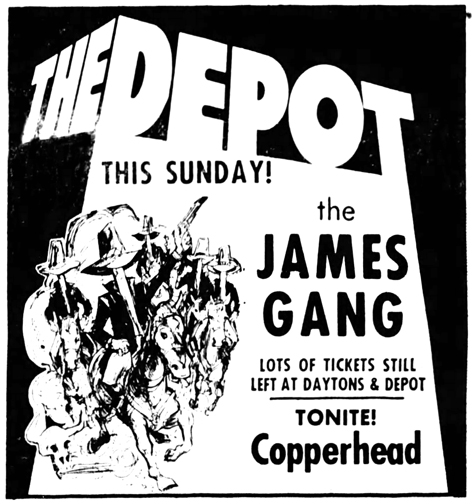
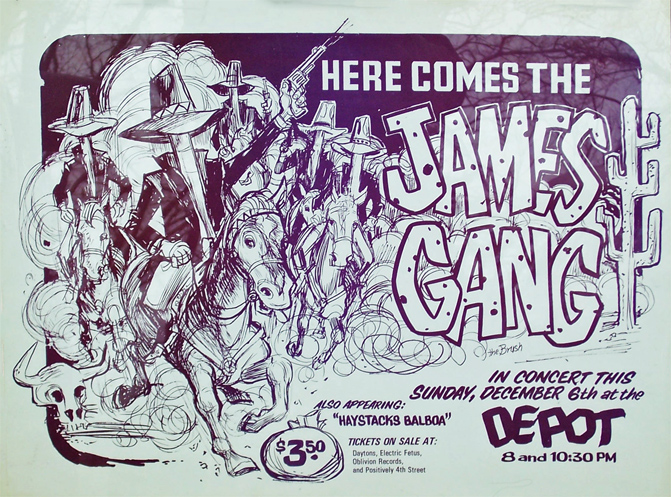
Poster from the collection of Mark Freiseis
Shows were scheduled for 8:00 and 10:00, but the second show was cut short by a family emergency, according to the Insider. Might be the show that was so loud that people left. The James Gang at this point was made up of Joe Walsh on guitar, Jim Fox on drums, and Bugsley Peters on bass.
Insider reviewer Phil Thomas opined that “Ned played about four songs too many, and the room was so thick with smoke that it seriously impaired both my vision and breathing.” (Insider, December 26, 1970 – January 9, 1971)
HUNDRED FLOWERS IS NOT HAPPY
An interview with the band published in the December 11, 1970, issue of Hundred Flowers was prefaced with this paragraph:
The James Gang played two shows at the Depot last Sunday night. About 3,000 kids paid $3.50 each to hear them. Another 1,000 or so were turned away. The Depot is probably the worst place in town for a concert. Those who could ignore the hot, very crowded conditions probably enjoyed the James Gang who were at their best during the second set, even though they were too loud for the Depot. They played a lot of their familiar favorites along with a lot of new stuff. On the bill with them was Ned, a very good group playing nightly at the Depot.
Probably because of this and other highly critical reviews of the Depot, the Depot apparently took away Hundred Flowers’ press pass. This ensued:
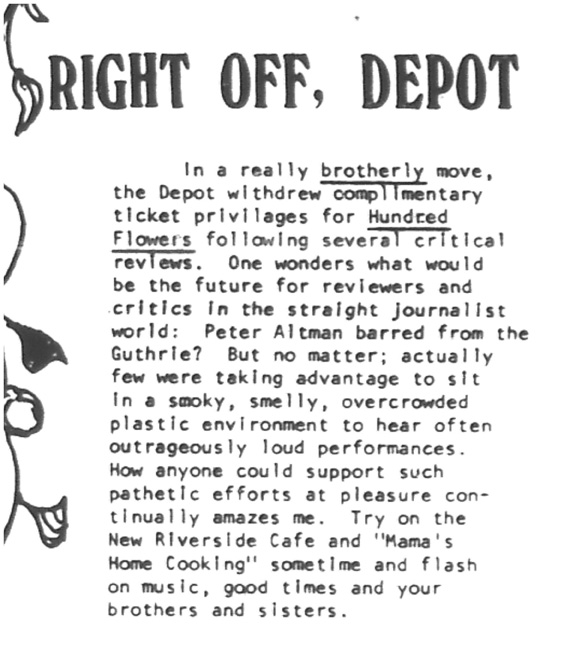
Hundred Flowers, January 1, 1971
December 10, 1970: Ned
December 13, 1970: Savoy Brown, opened by local group Grizzly (The December 12 Star had announced Haystacks Balboa and the opening act.)
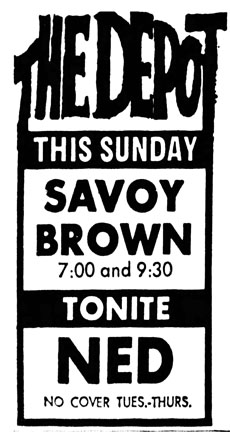
December 10, 1970
Well, Grizzly was on time, opening at 7 pm, but there was no sign of Savoy Brown, and poor Allan Fingerhut was wishing cell phones would hurry up and be invented. The band was supposed to go on at 8, according to Allan, and 9 according to the band’s manager. They finally showed up – their plane was late and the contract apparently did say 9 pm – and gave a 40 minute first set, according to reviewer Scott Bartell. “They played only six songs, but each one was long and loaded with music.” The encore was “Shake, Rattle & Roll,” with lead singer Lonesome Dave getting it on with voice and a mean guitar.
As for Grizzly, Bartell reported:
They are a pretty decent band with a good sound and some possibilities. They write some of their own songs (the lyrics are weak but delivered well), and know enough to vary their line-up: a medium-heavy boogy version of “It’s All Over Now,” an ominous “Summer in the City,” then a couple tunes of their own (one countrified and the other a fast rocker) and so forth.
December 20, 1970: Rhinoseros. There was a national band, correctly spelled Rhinoceros, and maybe this was them. You might recognize their instrumental “Apricot Brandy.” They broke up in 1971.
December 26, 1970, Connie’s Insider: “If it’s true, the Depot’s decision not to book Stan Kenton for $1,500 has got to be one of the biggest bummers of this or any year.” (For all he did for local rock ‘n’ roll, Connie was really a Big Band guy at heart.)
December 31, 1970: First New Year’s Eve
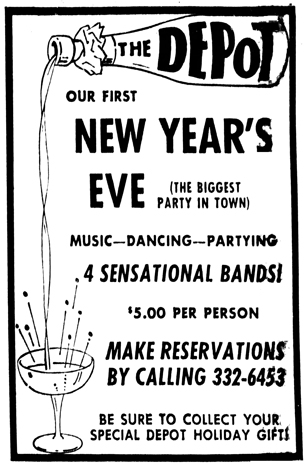
1971
January 2, 1970: Pride & Joy, a local band
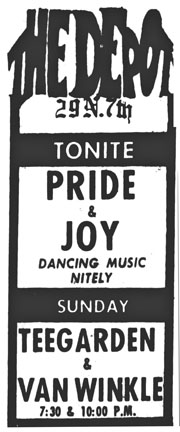
January 2, 1971
January 3, 1971: Teegarden and Van Winkel
Okay, this is a bizarre picture, predating the ED commercials by decades. Teegarden and Van Winkel’s one hit was “God, Love and Rock & Roll.” It was their first appearance if the Twin Cities.
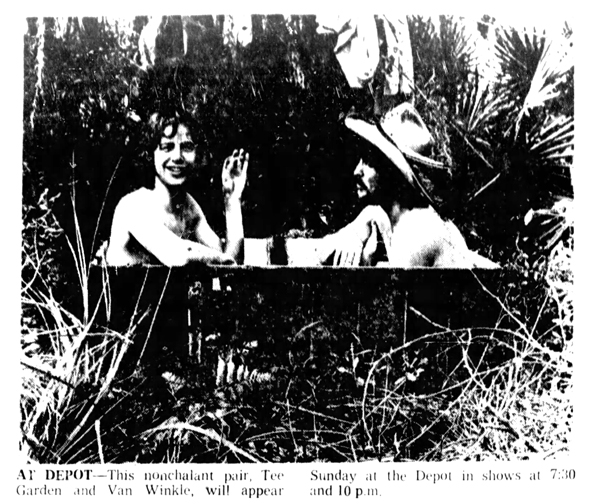
January 5, 1971: Grizzly
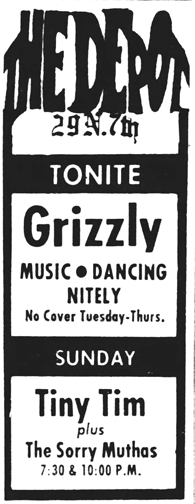
January 5, 1971
January 10, 1971: Tiny Tim, opened by the Sorry Muthas
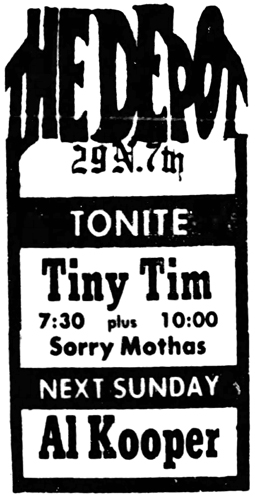
January 10, 1971
The perks of owning a night club is meeting the performers! Here are Allan and Sharron Fingerhut with Miss Vicki and Tiny Tim.
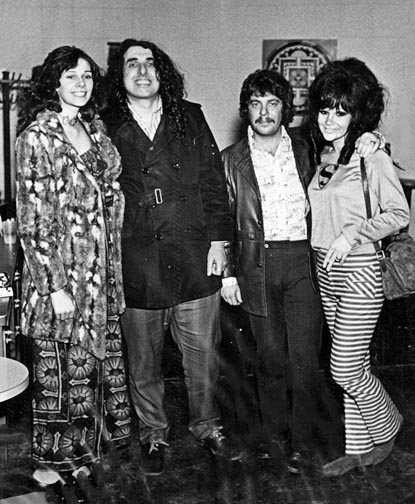
Photo courtesy Sharron Grohoski. From First Avenue: Minnesota’s Mainroom by Chris Riemenschneider, MNHS Press, 2017
By all accounts this show was poorly attended, probably because Tiny was also in town for the International Auto Show at the Minneapolis Auditorium all weekend where anyone who really wanted to seem him could probably do so for $2. He also appeared on KSTP-TV’s “Dial 5” program. Tiny didn’t care, telling Star reviewer Scott Bartell that “even if there’s only one person – the tables and chairs are listening.” Tiny was interviewed by local TV columnist Forrest Powers, where it was revealed that Miss Vicki was pregnant and that Mr. Tim had not been asked back to “Laugh-In,” the show that launched his career.
But according to Bartell, it wasn’t necessarily a bad show – in fact, he called it “funny and engrossing.”
He began with “The Waltz of the Bells” and “The Good Ship Lollipop.” Then he brought the band in for a super-long medley beginning with a World War I tune asking war critics, “What kind of American are you?”, switching to “Bad Moon Rising,” and proceeding through a very mixed bag of perhaps a dozen more fragments of songs. … He gives different treatment to all his songs — relative reserve on older tunes; writhing on the floor and throwing his necktie away on “Great Balls of Fire,” singing “Yankee Doodle Dandy ” through a bullhorn to get the old Victrola effect – yet he stamps each song with his own identity and people can’t help laughing and enjoying themselves.
At the same time he commands a strange respect – perhaps for sheer guts, but also because he does some things very well. For instance, he manages a duet with himself, imitating Sonny and Cher on “I’ve Got You Babe.” I guess it is that ambiguity that makes his work so captivating.
Bartell characterized the Sorry Muthas as a “good-time country and jug band.” “Numbers such as ‘Okie From Muskogee’ created the same kind of humorous tension between song and singer as Tiny did. The rest was just good, happy listening.”
January 15, 1971: Danny’s Reasons
January 17, 1971: Al Kooper and Friends, opened by Thundertre
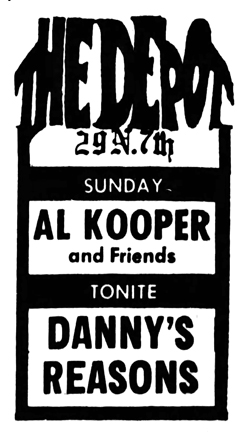
Minneapolis Star, January 15, 1971
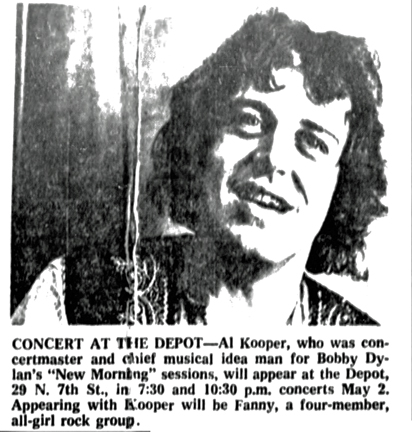
According to reviewer Marshall Fine, Kooper gave an “enjoyably funky show” to a packed house. He started the show with Elton John’s “Border Song,” and while Fine was not so impressed with his voice, he loved his instrumental work. Other songs included James Taylor’s “Country Road” and Nilsson’s “Without Her.”
Fine deemed Thundertre to be “a competent group with a lot of feeling in their music,” but lead singer Jeff (Schleppy) Shapira’s style was too much like Joe Cocker’s and got to be irritating after a while.
Fine also had a beef about the Depot’s light show, which was “one of the dullest since Edison discovered the tungsten filament.” But then, apparently, no one in Minneapolis knew how to put on a decent light show.
January 22, 1971: Danny’s Reasons
January 24, 1971: Mason Proffit, opened by Pepper Fog and Bluebird
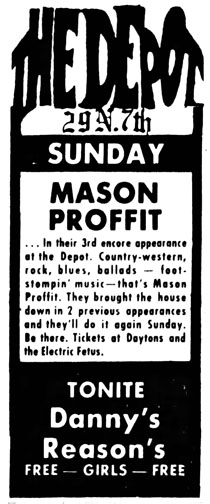
January 22, 1971
Scott Bartell described Mason Proffit as a country-rock band, very much appreciated by the crowd.
They have a way to working with an audience getting them on their feet, clapping and yelling, that brings a whole crowd together. And they are funny, too; commenting on the quiet house, Terry Talbot admonished them not to “try to partake us – we just ain’t that good!”
Bartell did not have a chance to hear Pepper Fog, but he did hear “surprise group” Bluebird, which used to be called Noys. He called them “definitely together,” and said, “They do some very competent though fairly commercial stuff. ‘Keep on Keepin’ On,’ a gentle little song they wrote, is very pleasant and I hope they do just that.
January 31, 1971: Sha Na Na, opened by Chesterfield Gathering
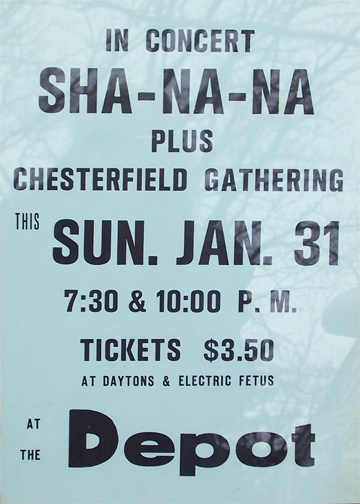
Poster from the collection of Mark Freiseis
February 2 to 6, 1971: Ramsey Lewis and His Gentle-Men of Jazz
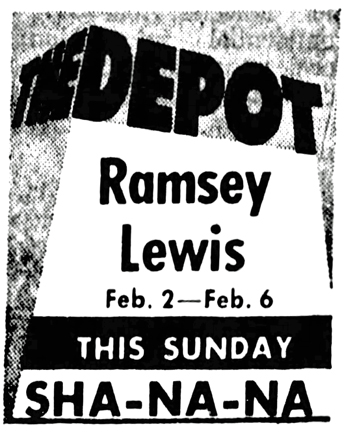
February 19, 1971: Suite Charity, a house band
February 21, 1971: Richie Havens, with Otis Plum, a three-man group from Chicago. Local/house band Crockett also remembers being an opening act.
Freelance reviewer Ann Payson described Havens as “an incredibly warm and charismatic performer” at the two sellout shows. His first set included several songs from his first album, such as “High Flying Bird,” “Just Like a Woman,” “Fire and Rain.” When he “ripped into” the show-stopping “Freedom,” Payson noted, “we saw the other side of Havens, his whole body moving, dancing in a frenzy across the stage and finally breaking two guitar strings as he pounded them in an amazingly sustained and powerful finale.”
March 5 and 6, 1971: Suite Charity
March 7, 1971: Crow, opened by Pepper Fog
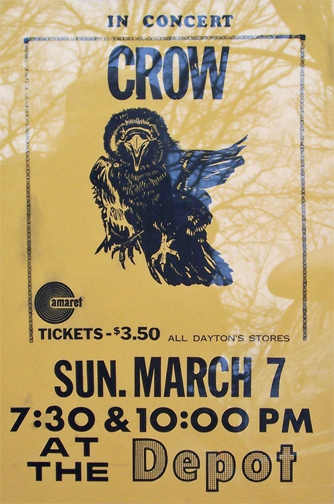
Poster from the collection of Mark Freieis
Scott Bartell’s review was scathing. On Crow:
- “Pretentious and filled with an justified frenzy.”
- “They have a very professional sound, but their writing is just not very original, nor are their performing styles.”
- “Lead singer Dave Waggoner just seems like a smaller, less aware Joe Cocker, doing more screaming than feeling.”
- “Denny Craswell’s drum solo near the end was really simple-minded.” Ouch!
Bartell even gave it to another local favorite, Pepper Fog, saying that “they still play heavy acid-flavored blues a bit too loud. My ears were nearly turned off by the time the featured group came on.”
March 14, 1971: Ike and Tina Turner
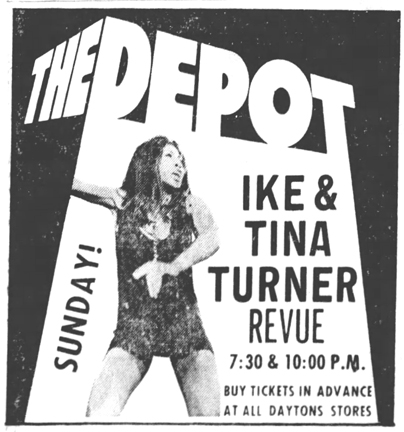
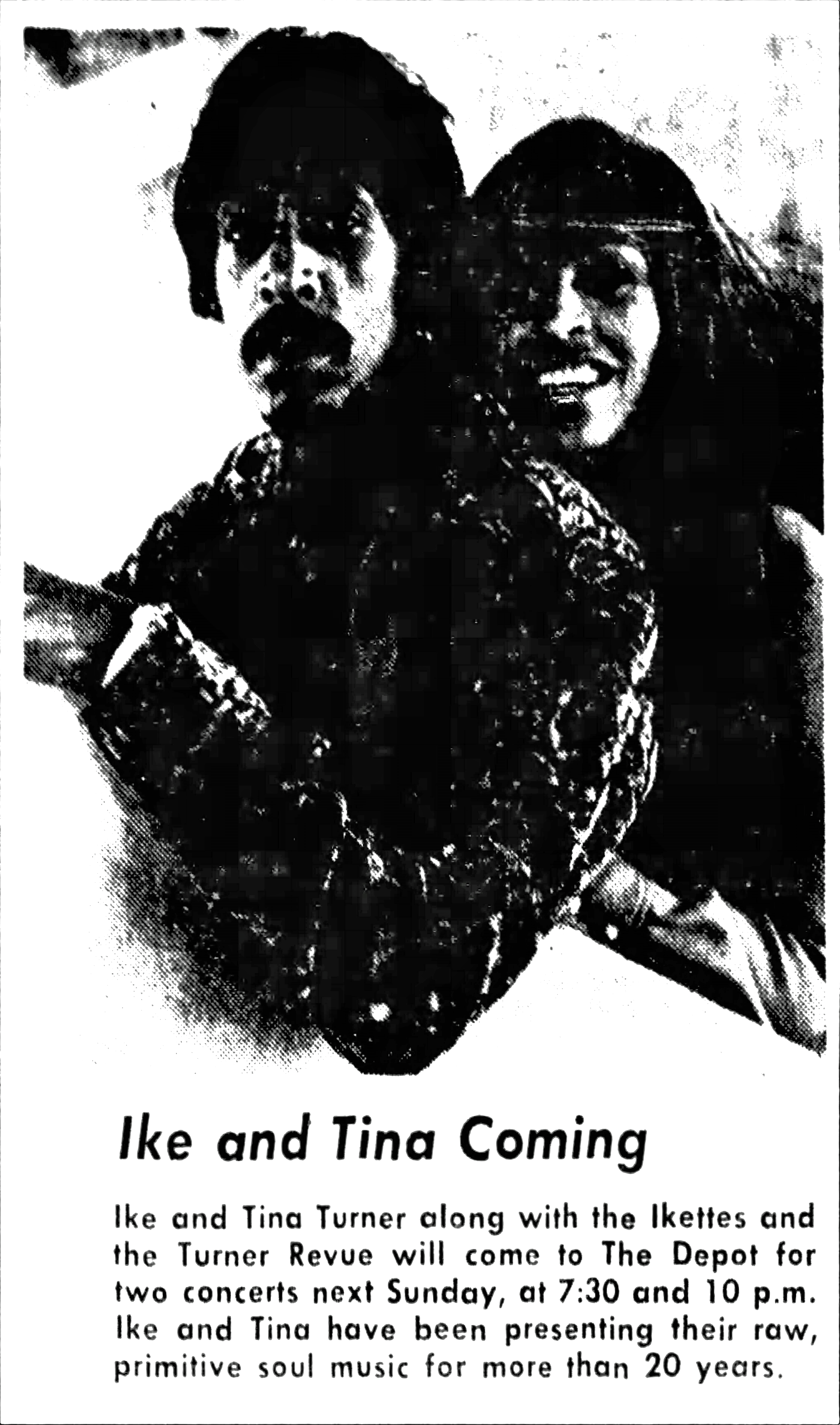
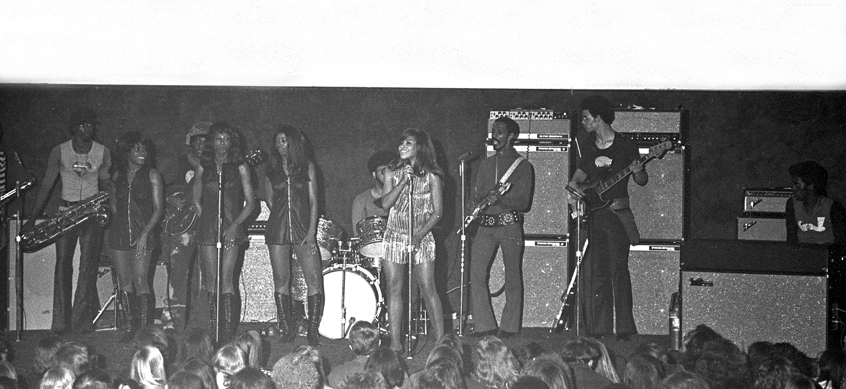
The Ike and Tina Turner Revue. Photo copyright Mike Barich, St. Paul
Ike and Tina were scheduled for two shows at 7:30 and 10:00. They got there so late that the people who came for the second show were left waiting in the cold and rain for up to 4 1/2 hours and the police had to block off traffic. Fingerhut told reporter Allan Holbert (Minneapolis Tribune, April 11, 1971) that:
Some of the customers, waiting outside in the rain, got fed up and tried to crash the gates. There were scuffles between them and some of the four or five off-duty policemen Fingerhut hires on big nights.
“Like there are seven exits in the place. We weren’t watching them close enough and the kids were coming in by the dozens. Next they found a way to climb up on the marque and come in the window.”
Fingerhut was furious at Ike and Tina’s manager. He called in comedian Ron Douglas to keep the crowd entertained until they got there, and had to do over an hour.
Ike and Tina finally arrived and said they would only do one show, but Fingerhut kept them to their contract and the second show didn’t go on until midnight. Fingerhut told Bob Protzman of the St. Paul Pioneer Press (April 11, 1971) that the antics of Ike and Tina “almost closed us down.”
Reviewer Scott Bartell reported that the band riffed while Ike was trying to change the details of the deal. Finally the Ikettes – “three black bombshells dressed in dayglo orange – burst on to sing and dance ‘Get Back’ and set the stage for Tina.” Most of their songs were covers:
- Piece of My Heart
- Wanna Take You Higher
- Honky Tonk Women
- Come Together
- Proud Mary
- I’ve Been Lovin’ You Too Long
- Son of a Preacher Man
- River Deep, Mountain High
but Bartell said that “they bring each number alive in a brand new way. They never seem to waste a second, and almost everything they do is worth seeing and hearing. Perhaps the best moments came when Tina was doing little dialogues with Ike on the blues “You Just Won’t Let me Be.” (Minneapolis Tribune, March 15, 1971)
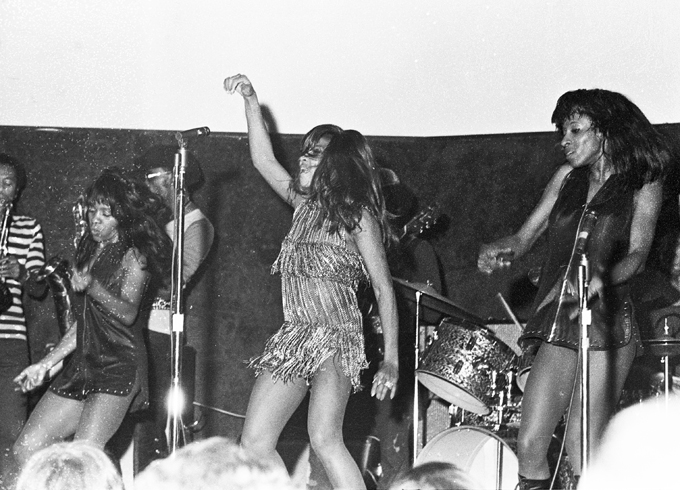
Photo copyright Mike Barich, St. Paul
Reviewer Peter Altman noted that the Ike and Tina Review was a well-oiled machine: “so carefully lit and costumed, musical arrangements (for all their sock) so meticulous, choreography so closely ordered and pace so shrewdly varied that even when the Turner Review is at its most dynamic one always appreciates that it is a smartly packaged entertainment based on strict adherence to a proven formula.” He noted that at some shows Tina “becomes a dervish who moves across the stage without touching the ground or the Ikettes abandon unison for ecstasy, and a few free choruses are allowed before Ike reasserts order. Such things did not happen this time” – or at least at the first show. (Minneapolis Star, March 15, 1971)
The Minneapolis Tribune dedicated a page in its picture magazine to the fashions worn at the Ike and Tina show. “Bell bottoms and jeans were the favorite garb with the audience … There were a few hot pants and some peasant and Indian looks in the crowd … The casually dressed crowd lined the balcony to watch the show.”
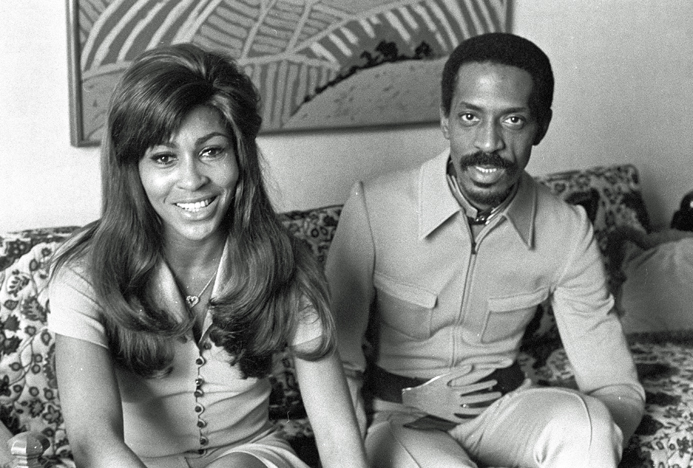
After-show Interview; photo copyright Mike Barich, St. Paul
March 19 and 20, 1971: Sir Raleighs
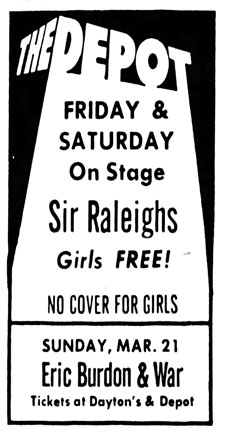
March 20, 1971
March 21, 1971: Eric Burdon and War, with plans to record for their next album live.
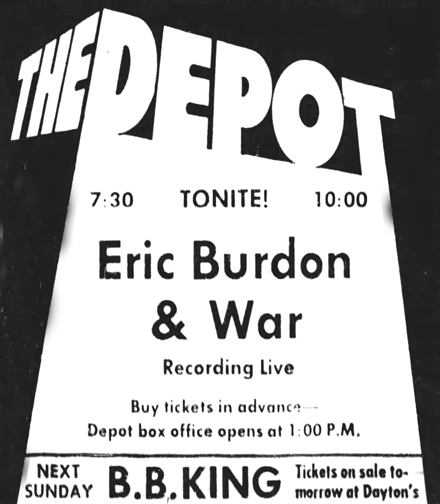
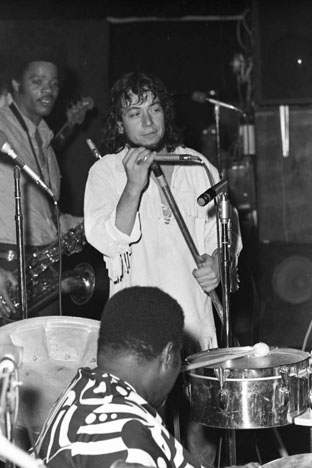
Photo copyright Mike Barich, St. Paul
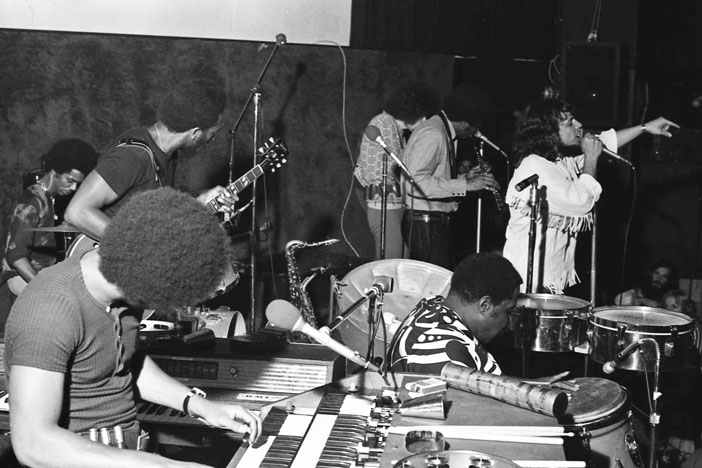
Photo copyright Mike Barich, St. Paul
Jim Klobuchar’s column, Minneapolis Star, March 26, 1971:
Come closer, visitors, so that I may share with you the latest and possibly most melancholy adventures of The Depot since it switched a couple of years ago from Mankato, St. Peter and LeCenter to the Pacific Gas and Electric. The latter is a musical organization of a type that The Depot now gives asylum against the ravages of the Golden Strings culture in Minneapolis.
March 27, 1971: Sir Raleighs
March 28, 1971: B.B. King, two shows
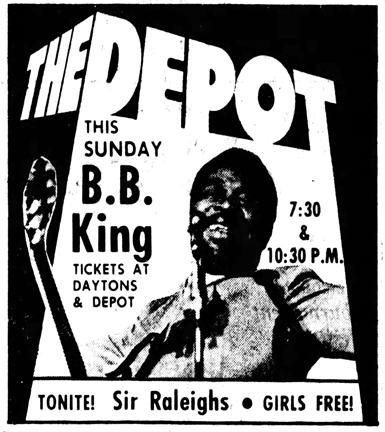
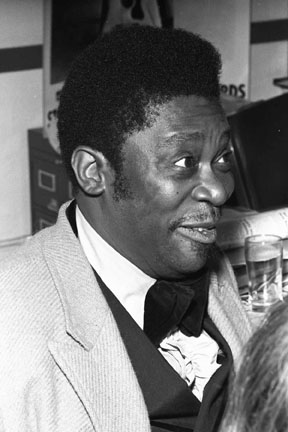
Photo of B.B. King copyright Mike Barich, St. Paul
April 4, 1971: Procol Harum, opened by Curved Air. Two shows, in the “City’s center of rock music.” (Star, April 1, 1971)
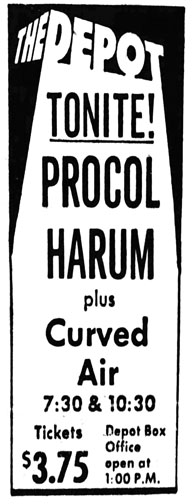
Robert M reports, “The Procol Harum (4 piece) show was poorly attended due to really bad weather. Everyone at first set was invited to stay for second set, which included a slightly different set list. Robin Trower played bass on a couple of numbers.”
April 9, 1971: Copperhead
April 11, 1971, James Gang (Jimmy Fox, Dale Peters, and Joe Walsh).
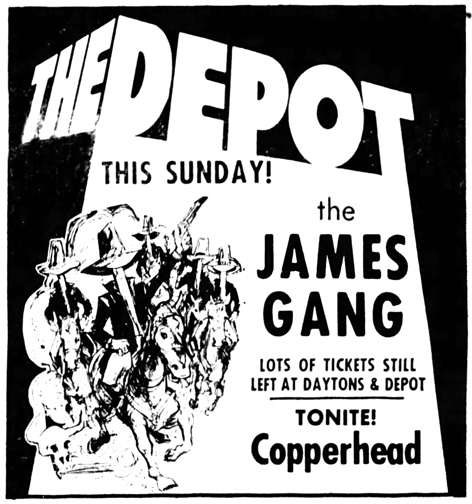
Minneapolis Star, April 9, 1971
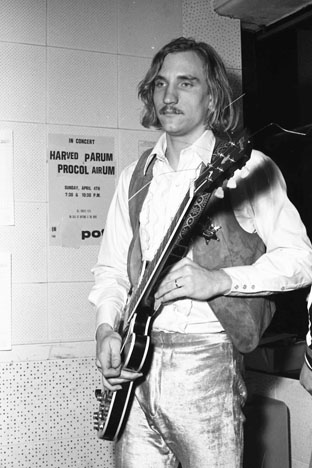
Photo of Joe Walsh copyright Mike Barich, St. Paul
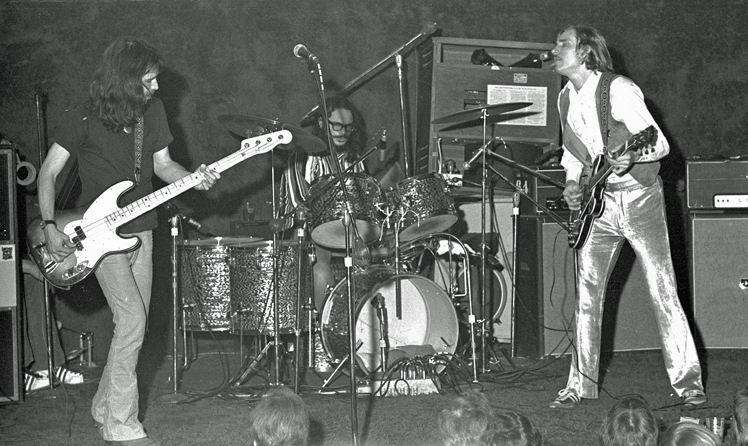
James Gang photo copyright Mike Barich, St. Paul
Peter Altman of the Star called the group’s sound an “instant anachronism.” While a year ago it would have been called “good but unremarkable,” “a sort of lower-case version of Led Zeppelin,” by 1971 “The individual is in; the group is out.”
It was easy to see that the Gang members were good players. But their music wasn’t saying anything about our world, or theirs. It had no lyricism, little sensitivity. It was aggressive, not reflective. And so it did not communicate directly. …
And the youthful audience, while friendly enough, never really cared; it was not involved; it will not remember vividly.
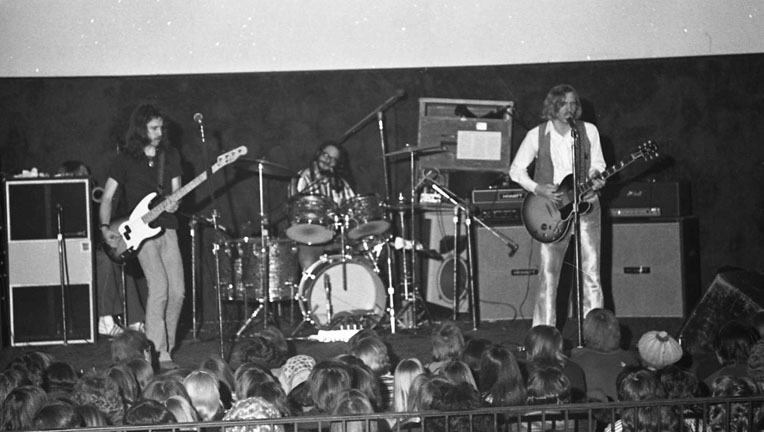
Photo of James Gang copyright Mike Barich, St. Paul
On April 11, 1971, Allan Holbert of the Minneapolis Tribune checked in at the Depot after a year of operation. He described the place:
Some nights it’s been a madhouse, with the music – after it finally started – so loud it was painful, with cops wrestling down rowdy rock buffs at the door, with bartenders running out of booze.
Other nights the loudest noise has been the moans of the management people as they added up the lack of receipts from paid attendance.
But the significant thing is that after one whole year, The Depot, that Fillmore Midwest rock palace… is still open.
Holbert also noted that April 1970 was not a great time to launch a new night spot. “The economy had started turning sour. People were being laid off. The ones who still had jobs were forced to cut back on their entertainment spending.”
Holbert attributed the success of the club to the hard work of Fingerhut, who “founded and owns most of the action” and was Chairman of the Board. Fingerhut worked seven days a week at the club. In hindsight, Fingerhut said that booking “loud, heavy groups” like Joe Cocker was a mistake, and “if I were to do it over I would start by booking top-40 bands.”
Crowd control was a lesson learned as well, as customers found ways to get into the club’s seven entrances and even in the windows without paying.
April 17, 1971: Copperhead
April 18, 1971: Canned Heat and John Lee Hooker, two shows
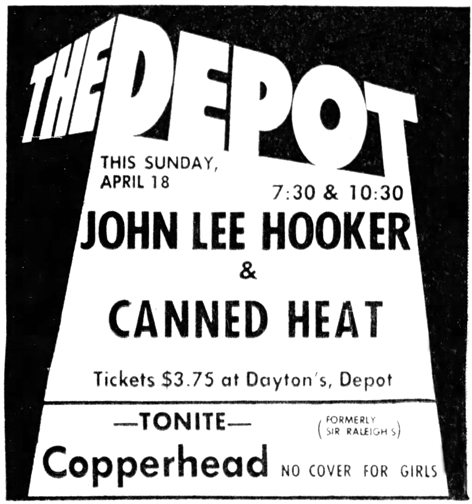
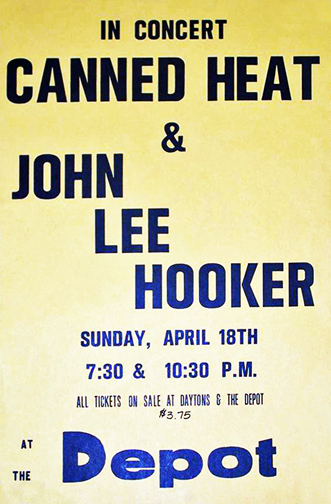
Poster from the collection of Mark Frieseis
Reviewer Jim Gillespie’s headline gives away his impression: “Too Much Canned Heat.” John Lee Hooker opened the show with a short set on electric guitar, with songs such as “It Serves Me Right to Suffer” and a short version of “Boogie Chillun.” Gillespie had the impression that Hooker’s set was cut short to let Canned Heat take the stage. By this time, co-founding member Alan Wilson had died, and Gillespie found the music to have a sameness that became boring. Hooker came back to join the group for the last number, “On the Road Again,” but did not stay, and Canned Heat closed the show.
Reviewer Michael Anthony agreed that Hooker’s set was too short (25 minutes at the most), saying “Hooker was a little subdued for an audience that came to stomp and shout.” He also mourned the passing of the group’s original lead singer, Alan Wilson.

Dick Guindon sketch from Minneapolis Tribune, April 18, 1971
The caption to the sketch above read:
The Depot, under the direction of Allan Fingerhut, has pulled off another booking coup, scheduling a combined appearance tonight tonight by Delta blues singer John Lee Hooker and Canned Heat, one of the best of the young, white blues bands. Their new album, “Hooker ‘n Heat,” shows that Canned Heat, as are a lot of other white young blues groups, is moving closer to the “source” with the help of veterans like Hooker.
April 23, 1971: Copperhead
April 24, 1971: Light and Foxglove
April 25, 1971: Gypsy
Gypsy was a local group that grew out of the hugely popular ’60s band the Underbeats to become nationally famous. Read the whole story of Gypsy at Minniepaulmusic.com
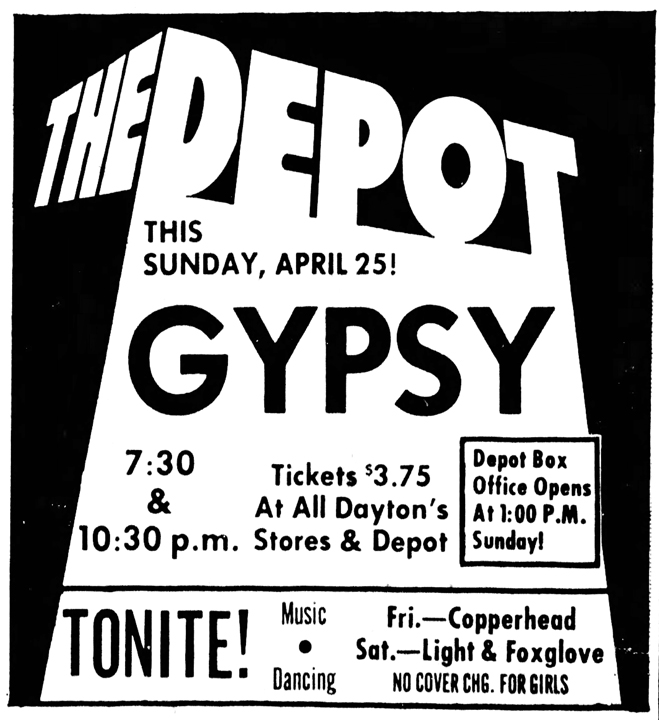
Ad dated Friday, April 23, 1971
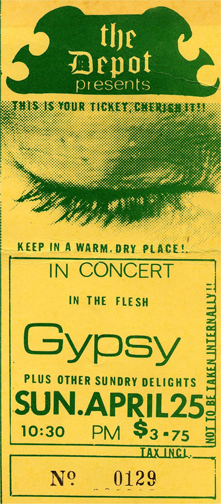
April 30, 1971: Copperhead
May 1, 1971: Bluebird
May 2, 1971: Al Kooper, opened by Fanny, 4 member, all-girl rock band.
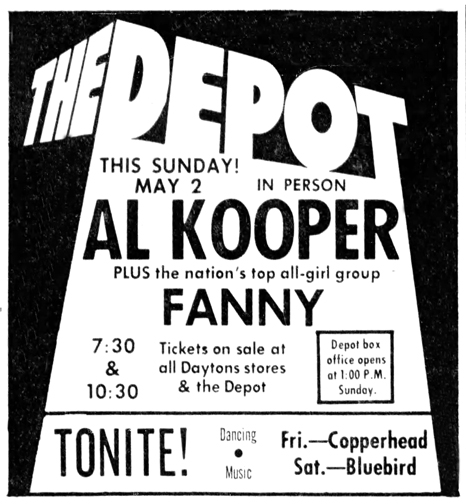
May 7, 1971: Dead Eye
May 8, 1971: Copperhead
May 9, 1971: Iggy and the Stooges, opened by the Litter. Little Richard was originally scheduled, but his tour was cancelled.
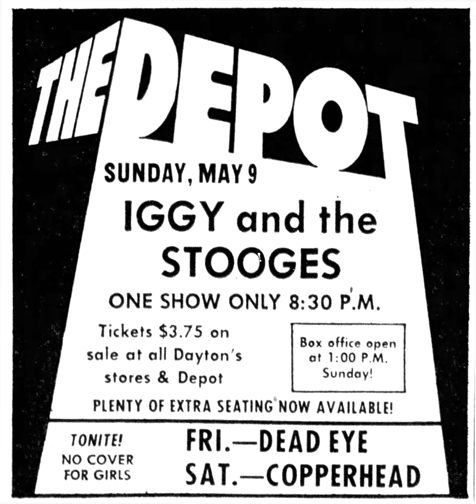

Poster from the collection of Mark Freiseis
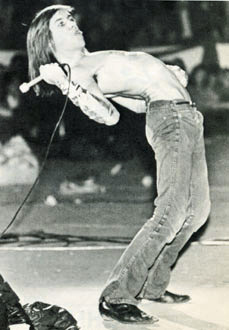
Iggy Pop photo copyright Mike Barich, St. Paul
Jeff G says Iggy “had a hundred foot cord on his mic and things got kinda scary when he ventured out into the crowd and got right into our faces before climbing up the wall onto the second floor.”
Reviewer Michael Anthony cited “interminable setting-up problems and much hand-clapping from the audience,” but finally out came Iggy: “topless, frosted hair, lips painted, sequined, greased body.” Here’s more of Michael’s review:
Iggy’s act makes Mick Jagger look like Rudy Vallee. He minces, prances, crawls on the floor, and turns his long pouting lips to the audience. He works mainly in the audience, falling, shoving, jumping on the back bar and up onto the balcony and occasionally singing. Looking from the balcony, with Iggy below, the people mobbed around him, clapping, it looked like Friday night in Haiti. Forty-five minutes after they began, the other Stooges, mightily bored, walked off the stage and Iggy got up off the floor, climbed on stage and walked off.
May 16, 1971: Redbone
NO COPS
As of May 17, 1971, Minneapolis Police officers were prohibited from working off-duty at the Depot, citing a number of arrests at the venue. Although Gordon Johnson, Deputy Chief of the Patrol Division, did not keep statistics on the number of arrests, he ballparked it at about once a day and claimed that judges and the city’s attorney’s office had made complaints. At the time, Fingerhut employed about 20 officers to check IDs. Deputy Chief Johnson said the order was not made because of the “character” of the arrests, but because of the number. (Minneapolis Tribune, May 13, 1971)
AMATEUR NIGHT
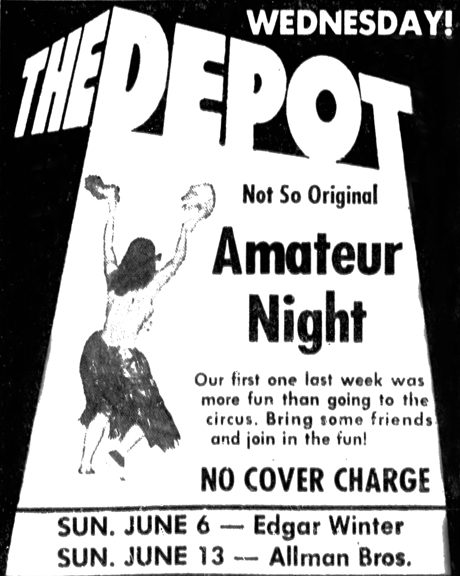
Toward the end of the Depot’s run, Fingerhut was trying different ideas to attract patrons. One was “Not-So-Original Amateur Night,” which made its debut on May 19, 1971. Planned to be an every-Wednesday night event, the contest would be award prizes according to audience response. Rock groups were not eligible, but apparently hula dancers were.
May 21, 1971: Bluebird
May 22, 1971: New Policy! Copperhead
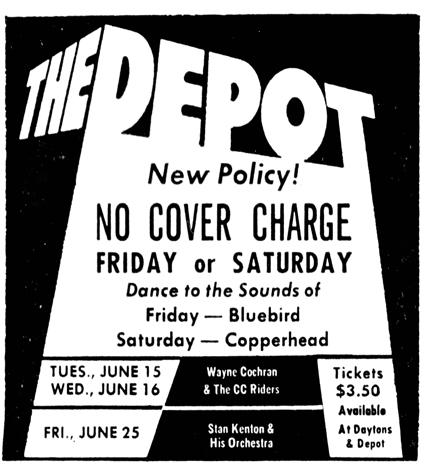
May 23, 1971: Johnny Winter, J. Geils Band
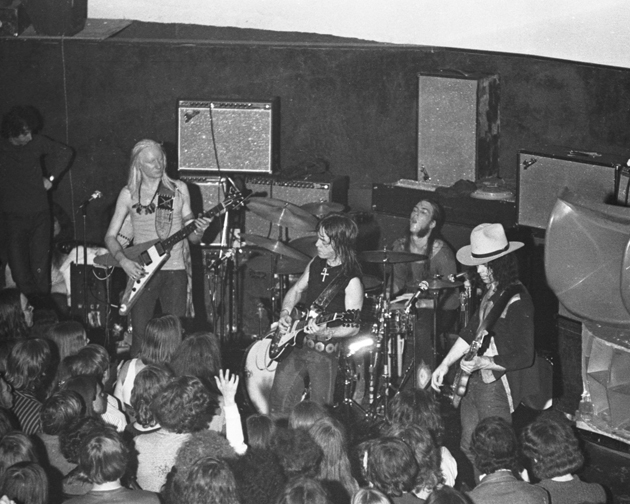
Johnny Winter photo copyright Mike Barich, St. Paul
Michael Anthony’s review noted that at least 1,500 fans jammed the Depot for the first set, with what seemed like another 1,500 waiting outside in the rain for the second. He called the first set mundane, with no real surprises, but only when comparing it to Winter’s past performances. Anthony noted that former McCoy’s guitar player Rick Derringer had joined Winter the previous year, and that while his guitar playing delivered “layer upon layer of 32nd note riff lines in unison and alteration, his singing left something to be desired.
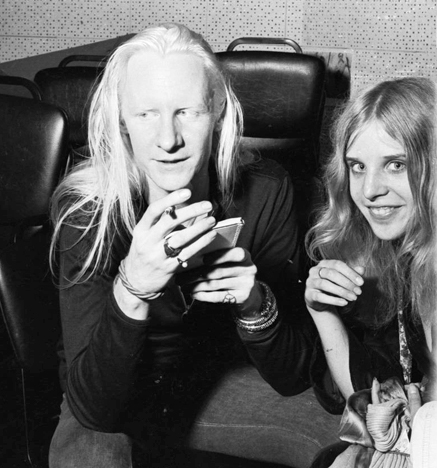
Johnny Winter and Sunshine – photo copyright Mike Barich, St. Paul
Marshall Fine noted that this was Winter’s fifth appearance in the Twin Cities, but that the group was getting “too obvious.”
Winter used to project a stage image of a white ghost, dancing some secret ballet with his guitar. There were high points and low points, climaxes and crescendos. He built his songs and then methodically, carefully took them apart.
His present band simply overpowers its audience. There are no real ups and downs in the songs because they all start on far too high an energy level. It’s simply power music, the genre that Grand Funk Railroad has made popular. The difference is that Johnny Winter knows what he is doing and consequently never becomes repetitious or dull.
The J. Geils Band was a relatively unknown group from Boston, which Fine found musically more interesting than Winter, akin to the Allman Brothers Band in their “hard-drinking approach to blues and the same smoothness and fluidity in their instrumental work.” Fine awarded kudos to the group’s harmonica player, Magic Dick, who “plays the most delicious harp since Paul Butterfield.”
The ad below appeared in the Strib on June 4, 1971. Wine and beer night had been extended to Thursdays, Nostalgia and Amateur Nights had been added, and cover charges were gone on Friday and Saturday nights. (The big concerts were on Sunday nights.)
June 6, 1971: Edgar Winter and his band White Trash

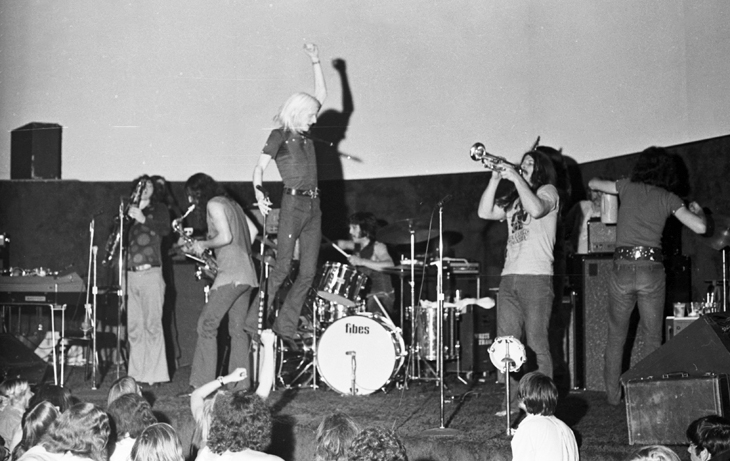
Edgar Winter photo copyright Mike Barich, St. Paul
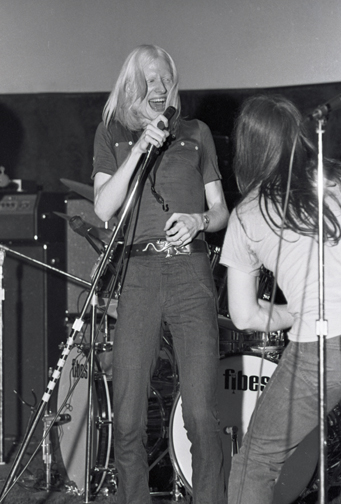
Edgar Winter photo copyright Mike Barich, St. Paul
Reviewer Marshall Fine enjoyed Johnny Winter’s brother, saying he was every bit as good, if not better, than his older, more famous sibling. “They have the precision of BS&T, the toe-tapping rhythms of Chicago, the harmonies of Three Dog Night, plus one other distinguishing ingredient: guts.” The set’s showpiece was a long version of “Tobacco Road.” With Edgar’s “wildly soaring voice, the song lost its oldness, as he gave it new dimensions and feelings.” Fine would have preferred that Winter do more of the singing, but that was left mostly up to Jerry la Croix, who Fine accused of looking, sounding, over-emotionalizing, and hamming shamelessly like David Clayton-Thomas. The first part was not necessarily his fault.
Robert M reported that this show (no Rick Derringer or Johnny Winter) “was really, really poorly attended – like 25 [450] people at most. They were asked to stay for second set which was exactly same as first. No opening act.”
FINANCIAL CRISIS
In Will Jones’s column of June 10, 1971, it was revealed that the low attendance at the Edgar Winter show threw the club into a financial panic. Said Allan:
We didn’t take in more than two-thirds of what we needed to pay the group. We were emptying out our safe, and even going into the cash registers to get change that we would need to open up on Monday, in order to pay them. Then something happened that you’re probably not prepared to believe. You know about rock groups and their reputations, and their wanting all the money before they go on and all that. Edgar Winter’s manager came to me and said he knew the club was in trouble, and he gave us back some of the money. He said he liked the club.. He gave us enough so that we could open up Monday. If you know this business, and the kind of people who usually run the rock bands, you know how unusual that is.
Jones reported that Allan had put the last of his personal fortune into the club and told his staff of about 50 people that he couldn’t meet the payroll. Jones thought that was a charitable move, since Allan had warned them in advance instead of stiffing them. Then the staff voted to work for free for a week in an attempt to keep the club open. At that point they were all hoping that the upcoming shows would come off. (Minneapolis Tribune, June 10, 1971)
On June 11, 1971, Allan, identified as the “majority owner of the business,” announced that Monday, June 14, 1971, would be the last night at the Depot. “The rock and pop music house will close its doors, and operations will be suspended indefinitely for financial reasons.” He said that the Friday before there were only 150 customers. He was stuck with $35,000 in bills and was contemplating bankruptcy. But he still had hopes of reopening the big hall as a concert venue. (Minneapolis Star, June 12, 1971)
CANCELLED FINAL SHOWS
June 13, 1971: Allman Brothers show was cancelled, even as it was advertised in the paper that day. The band got wind of the club’s financial trouble and demanded full advance payment before they even left New York. Fingerhut scraped it together, but when he called the next day they said that they had already rebooked the date.
The Allman Brothers show was supposed to be supported by a group called debb johnson, made up of high school kids playing Big Band Swing. There was no debb johnson, but the leader was Bill Barber, Jr., who played several instruments. Barber was the son of a jazz pianist father and a jazz singer mother. Will Jones really liked debb johnson.
June 15-16, 1971: Wayne Cochran and the CC Riders
June 25, 1971: Stan Kenton and His Orchestra
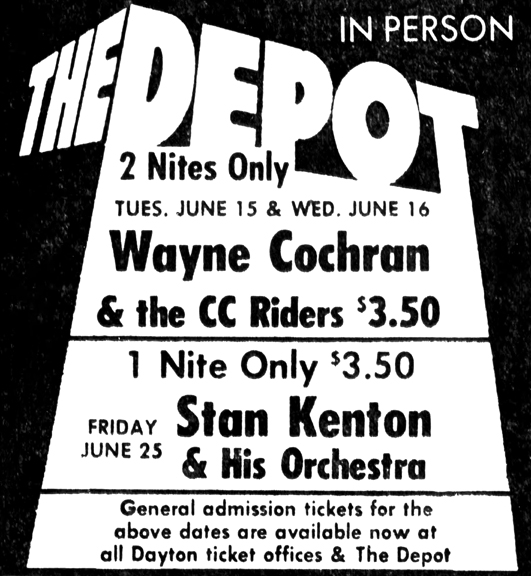
LAST DANCE
June 14, 1971 was the last day at the Depot, with music by house band Big Island.
Mike Anthony at the Strib said the crowd may have been even bigger than at opening night, ironic since the reason for closing was pitifully small attendance.
Hundred Flowers described the very last day this way:
For a year and a half the Depot crowd, a curious collection of “now” people, freaks, and in-betweeners, never really got together on anything. But, on closing night, June 14th, all the madness of rock-inspired frenzy broke out. On that night over a thousand people crammed into the place for the last wine and beer night.
The Depot management had not bothered to turn on the air conditioning or provide bar girls, so what developed was a chaotic human furnace. Add to this situation the tight, low-down, weasel-ripping music of Big Island and you have something quite close to heaven.
The band slammed into two of their own tunes “Four Days Screamin’” and “Let’s Get Reamed” and when the band stopped the people kept the beat going by clapping and shouting “more!” And that’s just what they got. Everyone moving and sweating as one body to “Jailhouse Rock” or another Big Island song “Mosquito Guts Against the Wall.” About this time the house lights were turned up and everyone was asked to leave (the cops were supposedly coming), but, of course no one left. Everyone was really ripped and all that was important was more raw face-kicking rock. “So the joint ke’p rockin’ .. all night long.”
The June 26 – July 11, 1971 issue of the Insider announced the closing of the Depot. The photo below was described as “a potential patron avoiding the ‘capitalist ripoff’ $3.50 admission plummeted 2 1/2 stories from the roof.”
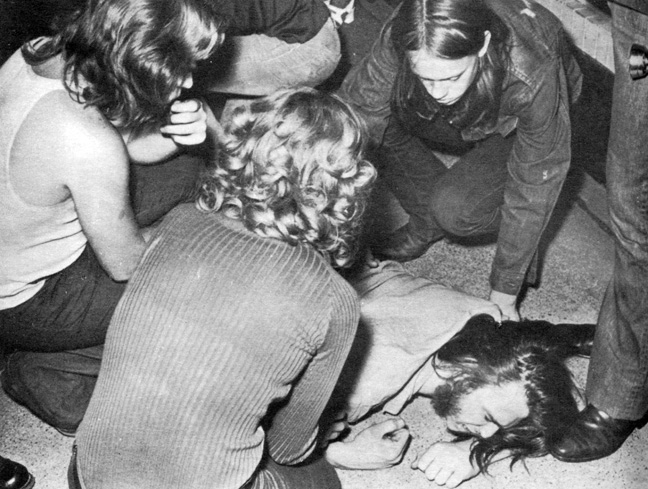
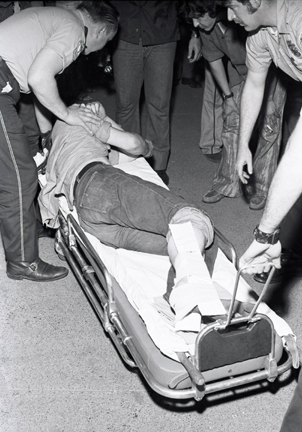
Anyone get his name? Photo copyright Mike Barich, St. Paul
POST MORTEM
Several factors closed the Depot, after two years of steady business.
GREEDY PATRONS
Hundred Flowers was an early critic of high ticket prices. As early as June 16, 1970, it published financial information on the first concerts, as provided by the Depot. Excerpts:
Like a lot of people, we suspected the Depot to be making a killing off our music and our people. We asked to see their books, and here they are. At this point, they seem to be more like benevolent patrons of the culture than vultures….
(A list of expenses and income for six acts, and three upcoming shows)
So that’s why the tickets are priced so high. Having the Minneapolis Fire Marshall limit the crowds to 900 doesn’t help either. Still, while many of you may be ending your personal boycott, many of us still can’t afford the tickets. When we talked to Fingerhut, the head honcho down there, he said he wasn’t in it for the money but then he said he’d like to stop losing money.
The Hundred Flowers article continued with some suggestions, all of which included the word “free.” Somehow making the venue into a museum would attract “every band in the country.” Or, let the “heads” do everything with volunteers. Hmmm.
THE COST OF TALENT
By 1971 the cost of talent had skyrocketed as much as 600 percent, with well-known bands wanting upwards of $50,000 for a night’s work. Allan told me that he paid Ike and Tina Turner $5,000 and charged $5 admission. Although $5.00 doesn’t seem like much to see a name band today, especially in a relatively intimate venue like the Depot, audiences were chafing about the prices and developing a mindset that concerts should somehow be free.
This phenomenon was taking place around the country:
Philadelphia’s Electric Factory closed shortly before Christmas, followed a few weeks later by the Boston Tea Party and most recently, two of the biggest – Fillmore East and Fillmore West. After six years in which his theaters were the meccas of rock music, Bill Graham announced on April 29, 1971, his plans to close both. (Tribune, May 23, 1971)
THE ECONOMY
Hand in hand with the higher cost of talent was the state of the economy in the 1970s, which was in sorry shape. It would only get worse, with prices sky high, gas lines, and the word “recession” in all the papers.
FINGERHUT’S “FORTUNE”
It probably didn’t help that Allan Fingerhut, who owned two-thirds of The Committee’s stock until 1975, was perceived to be wealthy at the outset, and perhaps could afford to put his own millions into paying the bands. After the Depot closed, Allan told the press that he was “tired of being called a capitalist pig,” but perpetuated this image of wealth when he said, “I didn’t really open the club to make a fortune because I’ve already got one.” (Minneapolis Tribune, May 23, 1971).
But the problem was that Allan wasn’t a millionaire – his father was. With the Fingerhut name, Allan was assumed to have personal control of a considerable amount of available funds. On the initial application for the liquor license, when asked for his sources of income, the form read “Trust. Fingerhut Manufacturing Co.” Unfortunately, nobody bothered to check his bank records.
Initial renovations were all on credit to The Committee, to be paid back with profits from the club (DS)
Allan was to put $150,000 cash into renovation costs, but when the time came, he did not have that much on hand due to pending lawsuits. (DS)
“Next, the man guiding the Depot’s operations and footing the bill for the massive decoration required, Allan Fingerhut, poured hundreds of thousands into his project…” (Connie’s Insider, April 11, 1970)
Will Jones reported that Allan had said that he had put in the last of his $280,000 fortune into the club and could not make payroll after that. (Minneapolis Tribune, June 10, 1971)
A profile of Danny described “millionaire Allen Fingerhut.” (Insider, October 1971)
During the bankruptcy of the Committee, Allan said he paid $570,000 of his own money in startup costs. (Star Tribune, November 13, 2004)
Allan “sunk $150,000 from his share of the Fingerhut fortune into interior renovation.” (CRM)
Whatever the amount, Allan did not have millions of dollars at his disposal to help pay for bands and keep ticket prices down. Patrons didn’t know this and resented having to pay what they perceived to be high prices to a millionaire to see their favorite bands.
Related to this point is that there was a strong suspicion that the bartenders were taking money home with them that wasn’t theirs, perhaps again with the rationalization that Allan was a millionaire and he was footing the bill, so he wouldn’t miss a little bit here and a little bit there. But it all added up.
As an aside, Joe Daskowitz (aka Papa Joe) managed Times Square and Danny ran the entertainment. Joe was interested in being Danny’s partner at the Depot but did not have the capital that was thought to be needed. Danny said later that if he had known how little Allan Fingerhut actually had, he would have gone with Papa Joe. (DS)
MARIJUANA vs. BOOZE
Bars make their money on alcohol sales, and the young audience preferred beer to expensive hard drinks. More, pot was what the mind-altering substance of choice, and since it was not on the menu at the Depot, profits suffered.
UNRULY CUSTOMERS
By the end of the Depot’s run, Allan was deeply disenchanted with the clientele and wanted to change up the talent to attract a “more appreciative audience.”
Arrests were increasing at the club – Allan said one or two a week, mostly on Mondays when the club served cheap beer and wine. As a result, on May 11, 1971, Gordon Johnson, deputy chief of the Minneapolis Police Department patrol division issued an edict that off-duty policemen could no longer work at the Depot, effective May 18. The Depot had employed 20 such officers to check IDs, and the move blindsided Allan.
The reason given by the police for the move was that “I think their Beer and Wine Night is getting out of hand. You’ve got people going in there getting blasted on wine and you know how silly some guys get on wine.” But do you arrest guys for getting “silly?” And this contradicts the complaint that the kids were smoking weed and not drinking enough.
To solve the problem, Allan announced his resolve to drop the rock-only policy and start booking acts that would appeal to an older and “straighter” crowd. He proposed booking acts like the Platters, Four Seasons, Pat Paulson, country western acts, or big bands. He already had the Stan Kenton Orchestra booked for June 25, which did not come to pass. Allan said, “Maybe we’ll get a more appreciative audience, not my age group, but more appreciative, anyway. We’ll have rock maybe once a month, but they’ll be just the good ones.” He said the demand for free shows on the part of the audience reflected “greed, pigheadedness, and disrespect.” (Minneapolis Tribune, May 23, 1971)
CASH FLOW
Both Danny and Allan mentioned the problem of the bands demanding half of their fee in advance. If the band had to cancel, which often happened, the band would return the deposit, but in the meantime the cash was unavailable for expenses.
FEUDING PARTNERS
In a profile of Danny in the October 1971 Insider, Danny was quoted as saying:
A lot of the burden fell on [Allan’s] shoulders because of his own mistakes. When it came to the point where he needed someone to help him make decisions, it was too late: I didn’t care to be involved. He simply made decisions without consulting anyone else. His brother-in-law was later brought in to make sure he stopped making the mistakes he did, but he still paid no attention to anyone. I tried to stop him legally, but all they ended up doing was slapping his hand and saying, “No Allan, you are not allowed to do that without your partner’s consent.” If we would have been left alone in the beginning, we would have been successful. With what we know now, if we were to open another club together, it would be successful.
Danny doesn’t remember actually bringing Allan to court; Ted Deikel was brought in to handle the dispute. (DS)
For Allan’s part, he was reportedly working 16-hour days, and his health began to suffer. People would have to drive him home, and his doctor advised him that the stress was too much.
DOLDRUMS
Between June 14, 1971, and the opening of Uncle Sam’s on July 1, 1972, the club was closed. But don’t think that it was quiet! In fact, I found out, thanks to documents provided by Danny, the City, and the State, that a scheme was afoot to take over the club and turn it into “The Scene West.” The plan had too many legal flaws and had to be abandoned, but I found it fun to put the pieces together. If you’re interested, the details are outlined in the last section of this page.
Another surprise was found on the cover letter that transmitted the Committee’s 1972 liquor license renewal application and fee. Committee attorney Melvin I. Orenstein’s cover letter stated, “The Depot has been inactive for the last seven or eight months. The company is now in the process of trying to sell its business and would, however, like to renew its license pending the completion of the sale.” The sale, of course, never happened either.
AMERICAN SCENE
Finally the Committee found a solution to its financial and management problems. On April 7, 1972, the Committee and a company out of Cincinnati, Ohio called American Scene signed a document called an Entertainment Franchise Agreement (EFA), which provided for American Scene to take over the management of the club and turn it into a link in their Uncle Sam’s chain of discos.
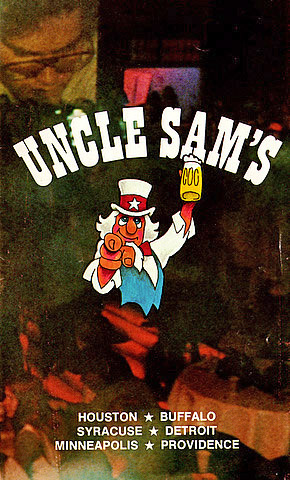
I have not found a copy of the EFA, but here’s what we do know:
- American Scene virtually “took over” the business, paying the rent, employees, providing an on-site manager, making entertainment decisions, etc. (SM)
- Contrary to several reports, Allan did NOT sell his shares in the Committee to American Scene. (BF, AF)
- The liquor license continued to be in the name of The Committee. (MLD)
- The business continued to be owned by The Committee.
American Scene made the place over into a “Saturday Night Fever” type disco (although the film wouldn’t be released until 1977), with a lighted dance floor, screens and projectors, and all the accoutrements that made it just like its other Uncle Sam’s locations.
[American Scene] had a notion that they could build a chain of dance clubs around the country in much the same way that Ray Kroc had built McDonald’s: by treating all markets alike and standardizing everything, including the name. (CRM)
UNCLE SAM’S: 1972 – 1980
*** PLEASE NOTE *** Performances listed below are for acts in the Mainroom only (once 7th Street Entry opened). In some cases I couldn’t tell, and included them just in case.
Also, although this website generally ends at 1974 and I don’t do local bands, I’ve broken both rules here by including acts (local and national) for this list through the Uncle Sam’s/Sam’s era.
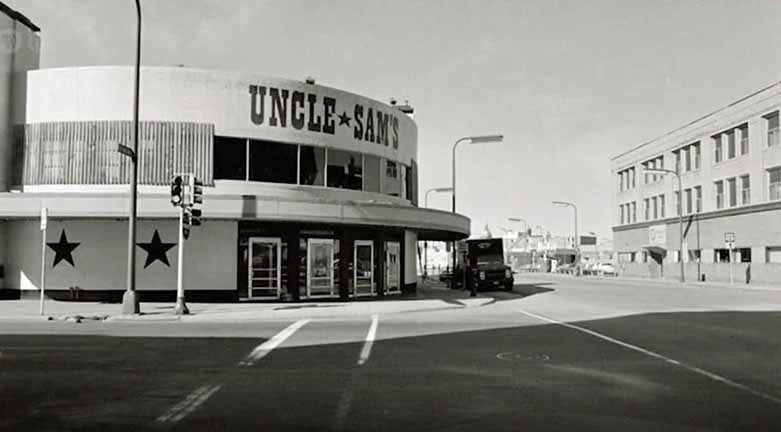
Image found on Facebook – unknown source
1972
An invitation-only Pre-Opening Party was held on Thursday, July 6, 1972.
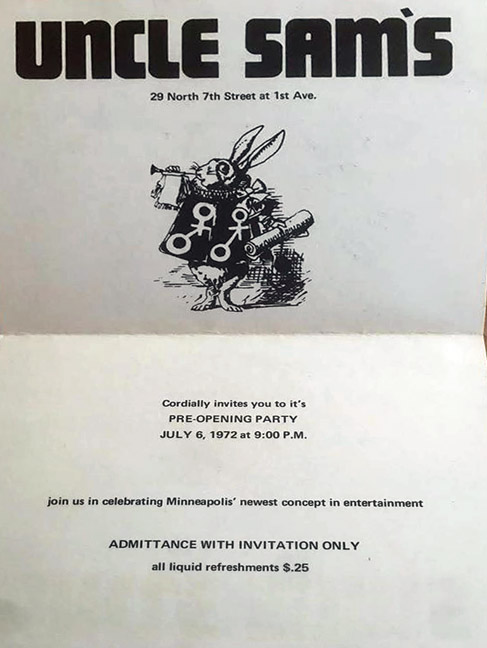
Courtesy Steve McClellan
The club was initially described as a discotheque, and the music was “computerized Top 40.” The new venue “eventually may offer live entertainment similar to the music groups booked by the old Depot.” (Minneapolis Tribune, July 8, 1972)
The opening weekend appears to be July 14-15, 1972. Doug Maynard’s band may have been the first to entertain at Uncle Sam’s.
Columnist Irv Letofsky reported that Uncle Sam’s was an instant hit, with over 1,000 paying patrons a night on its first Friday and Saturday (despite the fact that it seated 650). There was originally a dress code of no blue jeans and no hats, “to keep out undesirables.” They relented to “proper attire … But still no hats, because other people grab them and cause trouble.” (Minneapolis Tribune, July 16, 1972)
The no hat rule was interpreted to be a mechanism to keep out blacks, as was the “no canes” rule instituted from Cincinnati at one point. (CR)
On August 9, 1972, two young men from Menomonie were convicted of assault and breach of the peace after getting into a fight with four off-duty policemen working as bouncers at the club. Despite the fact that at least one of the young men required hospitalization from a beating from the police, they were each fined $100 and told that they were “old enough to know they are expected to walk away from provocation and not take up a fight every time it’s offered.” (Minneapolis Star, August 10, 1972)
By October 1972, Irv Letofsky was reporting that the club was drawing 5,000 people per week since it opened, well above break-even. (Minneapolis Tribune, October 2, 1972)
UNCLE SAM’S RECORDS
In the fall of 1972, Danny’s Reasons recorded a single that was issued on Uncle Sam’s Records. The song was the 1960 Ricky Nelson chestnut “Young Emotions” (one of my favorite songs…) arranged by Dick Wiegand and produced by Timothy D. Kehr. In a column/ad called Christian Cuts, put out by the Christian School of Hair Design, and published in the Minneapolis Tribune on February 4, 1973, the record was described as a hit record, and was Number 15. It did not say what chart, but this was clarified in a profile of Danny in the Minneapolis Tribune on March 4, 1973, as various radio charts in the Upper Midwest; it also did well in Duluth. The flip side was “Hard Old Times,” and the record was Uncle Sam’s No. 19361.
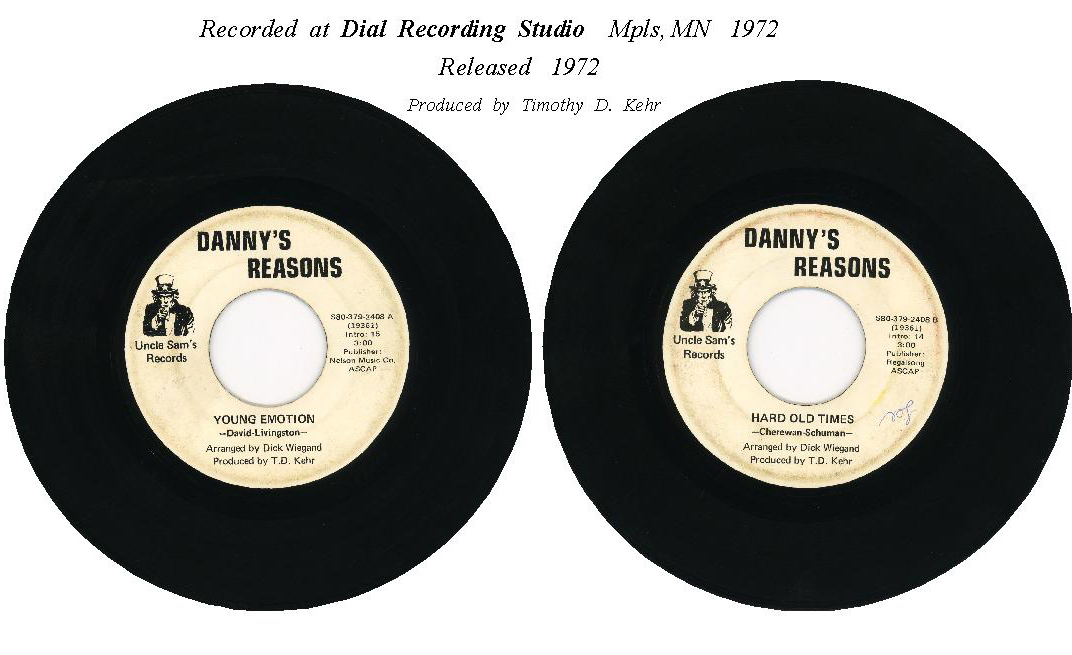
Image courtesy minniepaulmusic.com
The early ad below shows our Uncle Sam as a little bit more sinister than we’re used to seeing him. This was from 1972 or ’73, probably before the drinking age was dropped from 21 to 18.
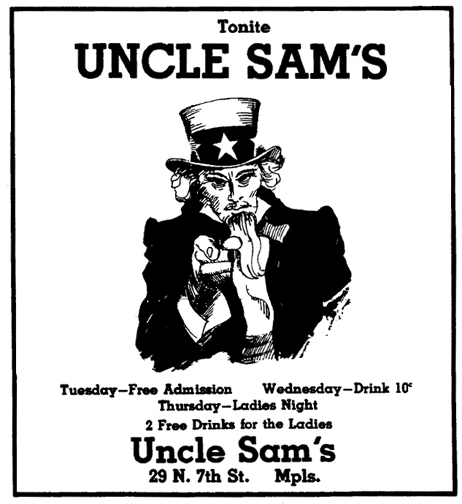
Minnesota Daily ad courtesy Robb Henry
1973
At first the club just played records, spun by a DJ. From 1973 to 1978, the main DJ was Steve Egsgaard, a former DJ at KQRS. (30th)
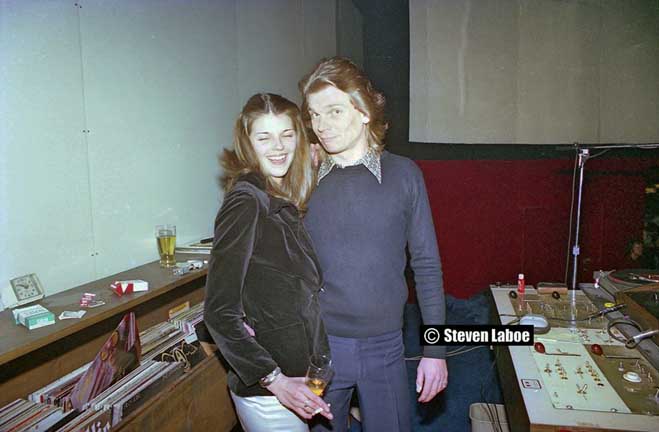
Steve Egesgard and friend in the DJ booth. Photo copyright Steven Laboe
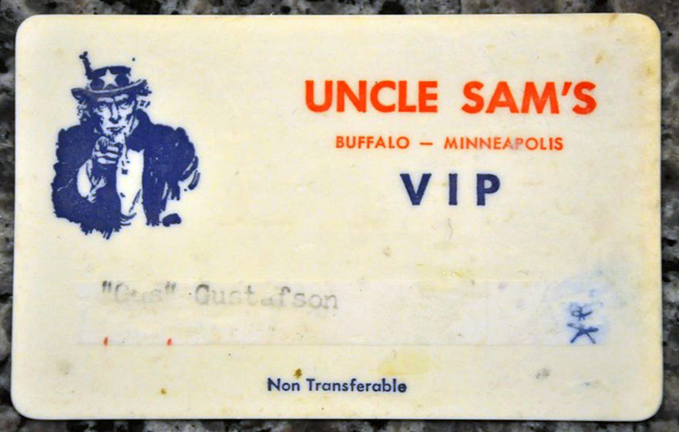
Steve Gustafson’s VIP Pass
By 1973 the club had started booking live bands. Sundays were often live music nights, mostly booked by Marsh Productions.

Minneapolis Tribune, February 4, 1973
February 11, 1973: Walter Mitty, featuring the brilliant Robb Henry on guitar.

Minneapolis Tribune, February 11, 1973. Ad courtesy Robb Henry
February 18 and 25, 1973: Willie and the Bumblebees

Minneapolis Tribune, February 18, 1973
March 4, 1973: Danny’s Reasons
Here’s a big one:
March 11, 1973: Colla was a band made up of former members of Crow, plus the mighty Gregg Inhofer from Pepper Fog.
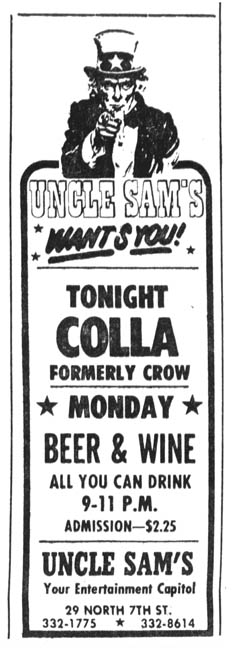
Minneapolis Tribune, March 11, 1973
March 18, 1973: Walter Mitty.

Minneapolis Tribune, March 18, 1973. Ad courtesy Robb Henry
March 25, 1973: Colla
April 1 & 2, 1973: Rock ‘n’ Roll Revival with Truc
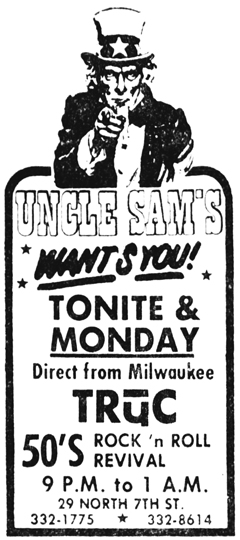
Minneapolis Tribune, April 1, 1973
April 8, 1973: Rock ‘n’ Roll Revival
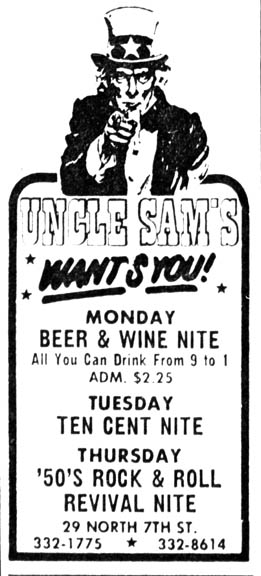
Minneapolis Tribune, April 8, 1973
April 22, 1973: Zulu
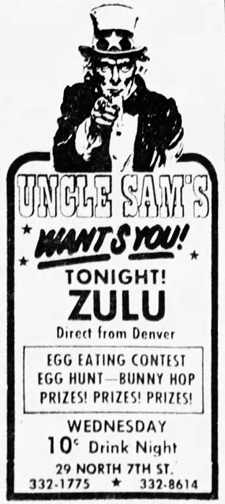
Minneapolis Tribune, April 22, 1973
May 7, 1973: Zulu
May 28, 1973: Zulu
Attendance was given a boost on June 1, 1973, when the drinking age in Minnesota was lowered from 21 to 18. The Tribune reported that at midnight on June 1, about 75 new drinkers appeared at the door at Uncle Sam’s, IDs in hand. (Minneapolis Tribune, June 2, 1973)
On July 3, 1973, an 18-year-old male was stabbed in the abdomen by a 22-year-old male as he was leaving the club after a dust-up over a girl. (Minneapolis Star, July 3, 1973)
August 13, 1973: Cain
September 2-3, 1973: Sterling
September 9 – 10, 1973: Jesse Brady
November 11, 1973: Sinaloa
December 3, 1973: Volcano
December 10, 1973: Sinaloa
December 14 – 15, 1973: Cain
This is the first mention I have found of many appearances that Cain made to Uncle Sam’s stage. Cain was led by consummate showman Jiggs Lee.
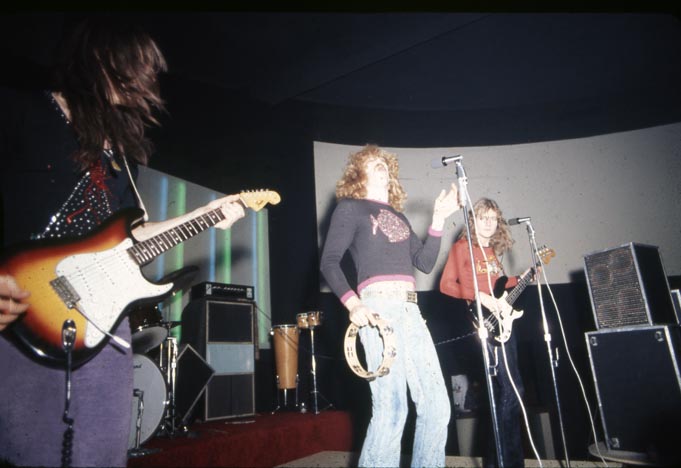
Photo of Cain (date unknown) at Uncle Sam’s copyright Steven Laboe. From First Avenue: Minnesota’s Mainroom by Chris Riemenschneider, MNHS Press, 2017
December 17, 1973: Everett James Band
December 25, 1973: Sinaloa
THE APE SHOW
Since Disco (capital D) had not yet hit the culture, drummers were still being hired to beat out the rhythm of the rock songs being played by the DJs. One drummer took it to a higher plane entirely. The following was taken from Douglas Hegle on YouTube:
Denny Craswell was a founding member of the Castaways, and co-wrote its smash hit, “Liar, Liar” in 1965. In 1969 he became the drummer for the band Crow, which had a national hit with “Evil Woman.” The band put out three albums; the second, “Crow by Crow,” received much local and national attention. It featured the cult classic “Cottage Cheese,” which was written as a vehicle for Denny’s drum solo.
After Crow disbanded in 1972, Denny decided to try something different. He met with the Tribal Leader of the Taos Native Americans in New Mexico. He was granted special permission to build a drum set out of Taos Drums. He added Timpanis and gongs and a Rack of 18 Tubular Bells. The hardware was custom made by a Greek wood carver. The thunderous prehistoric drum set had to be played with mallets, which was perfect for a FIRE DRUM SHOW.
Next, a keyboard was added to the setup. In 1973 MIDI (Musical Instrument Digital Interface) did not exist, yet Denny built a master controller that could control custom programmed Chamberlain organs and synthesizers. The Chamberlains featured the sounds of a huge pipe organ and vocal choir.
Add a bunch of Explosions, Smoke, Fire, and an Ape Costume, and The APE SHOW was born! APE performed at Uncle Sam’s and other Minneapolis Clubs before he went on tour across Wisconsin, Illinois, and as far as Pennsylvania and back across the country, finally landing on the West Coast.
Miraculously, a video with photos of the Ape Show is now on YouTube!
I would also like to point out that Denny Craswell is kind of my cousin. You see, his father’s brother married my father’s sister. So it isn’t a blood connection. But we both shared Uncle Dick and Aunt Arlene. And although I’ve known his brother Jay and even babysat for his sister Melodee’s kids when I was very young, I never actually MET Denny until 2010 when he was inducted into the Mid-America Hall of Fame. What a blast to see my Craswell aunt, uncle, and cousins out to see Denny perform both his Castaways and Crow numbers! He is still performing up where he lives in Detroit Lakes.
1974
February 9, 1974: Straight Up. The January/February Insider reported that “lead singer Mark Gallagher is back (are hot pants still in?) The show includes fire, smoke and outlandish costumes (Ex-Litter turns glitter)…” Straight Up’s act required a lot of space, so they mostly performed in outstate ballrooms. In addition to Gallagher, ex-Litter drummer Tom Murray was in this crazy group. See a Dave Moore special report on Straight Up Here.
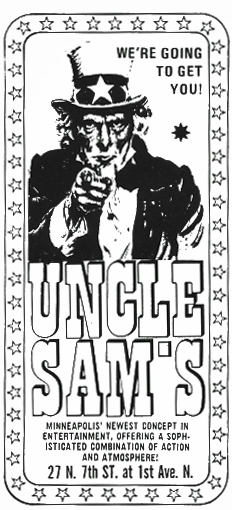
Insider, March 1974
NO POCKETS, NO CHANGE
1974 was the year of the streaker, and on March 12, a nude man who appeared to have come from Uncle Sam’s showed up at the Venice Cafe across the street and ordered a pizza. The proprietor said he would make him one but he couldn’t wait for it there. The streaker paid with a $20 bill but couldn’t take his change because he didn’t have any pockets. Friends of his picked up the pizza. (Minneapolis Star, March 12, 1974)
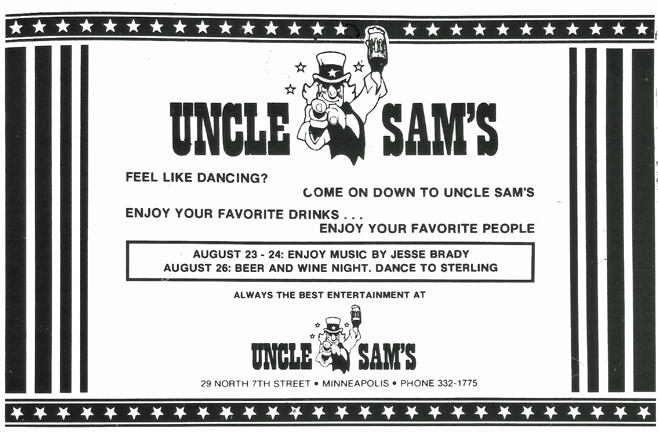
Insider, August 1974
RIOT LEADS TO OWNERSHIP PROBE
For some reason the bar was holding a Grand Opening (or Re-Opening) Weekend during September 13-15, 1974, with free admission and 25 cent drinks. One young man was reportedly harassed for wearing a red beret and having painted fingernails – a witness said that police called him a “faggot and a queer.” One report was that the cop bouncers ejected him for “violating the dress code.” The young man did not consider his beret to be a hat. Nevertheless he was allegedly put in a half-Nelson hold and thrown against a police car. This did not go well with the crowd (2,000 people had been through the doors that night), and a “row” resulted in nine arrests, mostly by friends who tried to intervene.
The next day (a Saturday), the city attorney’s office promised an investigation based on the number of complaints of brutality from the people arrested. The investigation ended up in the hands of the police chief, who was looking into the ownership of the bar and the number of complaints. (Minneapolis Star and Tribune, September 13, 14, 17, 1974)
A report in the Tribune on September 18, 1974, stated that the liquor license “is held by a group called The Committee, Inc., of which Allan Fingerhut is President.” The club was managed by Cincinnati-based The American Scene, Inc., which took a share of the profits. City ordinance required that liquor establishments must be locally owned, and the council wanted to look at the source of the club’s financing.
On October 2, 1974, the Tribune reported that no legal action would be taken against the two officers involved with the fracas, but “their actions were not up to the standards we expect of them,” said City Attorney Walter J. Duffy, Jr. But the council was still concerned about the license, suspicious that the Ohio group secretly was the owner.
On November 11, 1974, Minneapolis Mayor Albert J. Hofstede announced that he would instruct Police Chief Jack Jensen to forbid police officers to work after hours at Uncle Sam’s. He wanted to forbid all moonlighting, but he couldn’t afford to pay officers time-and-a-half so they could make a living wage. With permission, Officers could work any job except bartending after hours. (Minneapolis Star, November 12, 1974)
An article by Joe Soucherey in the Tribune dated October 17, 1974, indicated that Cain had recently performed at Uncle Sam’s. Soucherey had once been a member of the Bananas, before they changed their name to Cain.
November 15-16, 1974: Sterling
November 18, 1974: Prodigy
November 19-22, 1974: Cain
December 7, 1974: Prodigy
December 16-21, 1974: Sterling
December 22, 1974: Cain
December 30-31, 1974: Sterling
ABOUT THE WORD DISCO
I don’t pretend to be an expert on this, and I won’t attempt any involved analysis, but here’s my interpretation. In the beginning, a discotheque was merely a club that played records instead of having a live band. In the early days, Uncle Sam’s was a disco (I’m going to use a small “d” disco here) sometimes, but there were many nights through 1975 where live bands (mostly Jesse Brady and Sterling) played live. It was the format, not the characteristic of the music.
The trend of bars that just played records (disco with a small d) started cropping up at the end of 1974, apparently – an article in the December 1974/January 1975 issue of the Insider by Editor Peter Dwyer announced “Discos are the coming thing.” The three “discos” mentioned in the paragraph were:
- The Red Eye Saloon disco bar “featuring rock music,” at 1019 Washington Ave.
- Zelda’s, an affiliate of the Spaghetti Emporium, on 4th Street South. Zelda was the person who would manage and run the disco board.
- The Tea Room adjoined the Locker Room, a 24-hour steam bath. The Tea Room, located at 315 First Ave. No., was open midnight to 4am, Wednesday to Sunday.
Of course all Uncle Sam’s clubs had been offering dancing to records for a few years now. They were all the same, as described by Billboard magazine, December 21, 1974:
Dancing to records backed by the live drummer is the whole lure. Each Uncle Sam’s has a large dance area averaging about 60 by 12 feet. A computerized chase-rotate-and-flash electric circuit matches the 40-foot wall of lights and multi-colored lighting under the foot-high transparent plexiglass dance floor with the rhythm of the record played. Overhead, six strobe lights are calibrated to match the rhythm. There are stationary black lights and several bubble machines in the dance area.
1975
BILLBOARD
An article dated February 8, 1975, in Billboard reported that the club in Lincoln, Nebraska, had opened on January 28, and another one would open in Maxville, Tennessee, on March 15. They were already open in Houston, Detroit, Des Moines, Buffalo, and Syracuse.
Pat Lyons, the manager of the Minneapolis club, said that the company had a space requirement of at least 10,000 square feet and capacities ranging from 1,000 to 1,5000 persons. The firm’s policy was to build a $35,00 – $40,000 lighting/sound system in each location. Food was not offered in any of the clubs, but alcoholic beverages were available. Admission to each disco was $1.
With the exception of the Minneapolis club (it has live music six nights a week unntil just recently), the programming format at each disco is designed to give the ddancerss a wide variety of sounds, including r&b, pop and rock. The norm, says Lyons, is for each club to play at least 75-80 different records a night.
Playlists of the DJs working the clubs come from the home office in Cincinnati but, at the same time, are used primarily as guidelines. The individual spinner and manager in each club is allowed freedom to work their audiences as they see fit.
The article mentions a “comment sheet” from each club that is ciruculated throughout the clubs to alert managers to trends and give them ideas. Lyons said that recent comment sheets indicated that 80 percent of club-goers “prefer recorded dance music over live entertainment.”
THE INSIDER
In March 1975, Peter Dwyer of the Insider filed this report:
Apparently the live music gig in some clubs isn’t doing too well. Several clubs in town are trying a disco format to cut costs and bring in the dancing crowd. Uncle Sam’s reportedly followed the lead of its national affiliates in changing to a complete disco program. They’ve imported a jive-slinger from Syracuse, New York, to get the crowd off their wallets.
[Mentions of discos at The Golden Fox, Red Eye Saloon, and Zelda’s] These clubs provide an interesting and varied alternative for the bar hopping crowd without really posing much of a threat to the gigs available to musicians, that is unless the trend continues to turn away from live music.
Yes and no.
March 31, 1975: Jesse Brady
April 9, 1975: Chubby Checker. Why didn’t I go to this show? I was a fifties freak in the seventies!
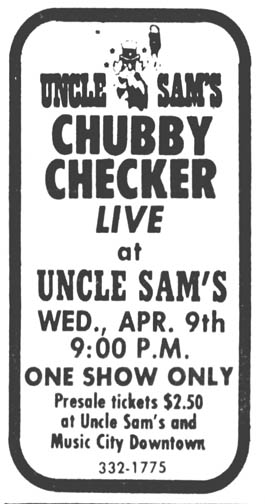
Dix Steele remembered:
I worked there this night. It was unusual as we didn’t regularly do live music in those days. What I do remember was that Chubby Checker did two shows that night. Both for the same audience… It was a bit confusing to people…
MY FIRST TIME
I turned 18 on March 17, 1975, and my sister Judy was already a dedicated Uncle Sam’s addict, so on Monday, June 30, 1975, she brought me to her favorite venue for the first time. (I keep a diary, you see…) Things were going fine, I was dancing with a harmless-looking guy named Ryan, when all of a sudden he said, “See you after the contest.” What contest? A wet T-shirt contest. Girls got up on stage in special T-shirts (probably promoting a radio station) and their underwear. Some guy (probably a DJ from U100) poured a pitcher of water on each. Applause for each, some were eliminated. Off go some of the T-shirts. Applause, applause, still no winner. Guys were standing on the bars and pool tables (did they have pool tables?) shouting “Beaver! Beaver!” I did not know what that meant. Off go some of the underwear, and presumably the prize was worth the attention. Or vice versa. I was mortified! And so mad at my sister for not warning me not to wear that halter top… I’m told there were about five of these, er, special programs held.
The photo below is not from the event I was lucky enough to witness. Yes, it is offensive and gross. Sometimes history hurts.
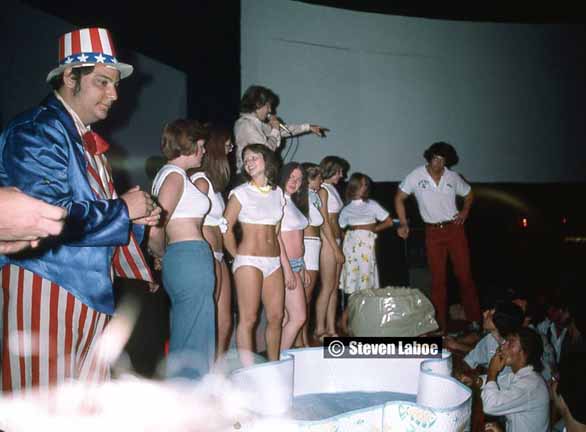
1976 photo copyright Steven Laboe
Drink and Drown Mondays were discontinued and replaced with additional live music nights in 1975.
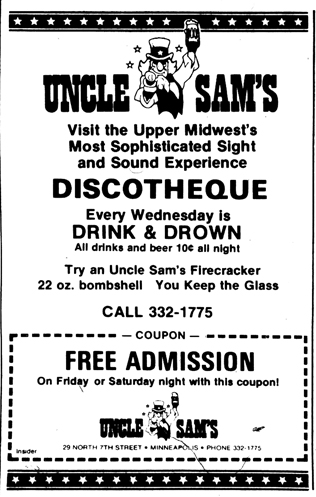
Insider, September 1975
The mural pictured below was painted by Mike McCarty in the fall of 1975 – at least that was the consensus after much discussion on Facebook. At the time it the photo below was taken in 1977, the space was the Game Room.
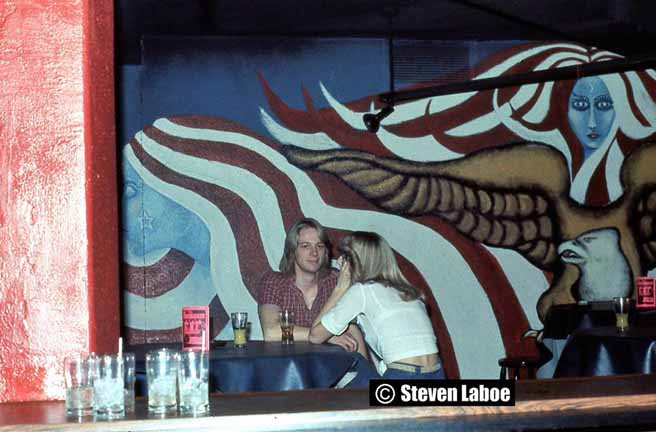
Photo copyright Steven Laboe
EARLY UNCLE SAM’S
An article from October 1975 gives out these tidbits about the club at that time:
- The clientele was predominantly 18 to 25.
- Although liquor was served, beer was the drink of choice.
- Jim Crake was the doorman.
- The dress code was as follows:
- No ripped, patched, or frayed jeans
- No hats
- No T-shirts
- Proper Attire required
There is no band. Inside the walls vibrate with 5,000 watts of hard rock and multi-colored lights under the dance floor create a fantasy-world atmosphere. There is a “disc jockey” on stage, along with a drummer, who adds a thumping beat to the 5,000 watts of stereo.
Technology fills the room at a price below musician’s union scale. (Minneapolis Star, October 31, 1975)
DRUMMER DEAN
Dean Pederson was one of the staff drummers from 1975 to 1977, and he was kind enough to send in the following photos from his time at Uncle Sam’s.
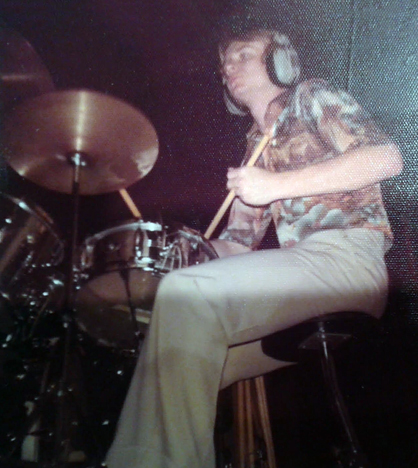
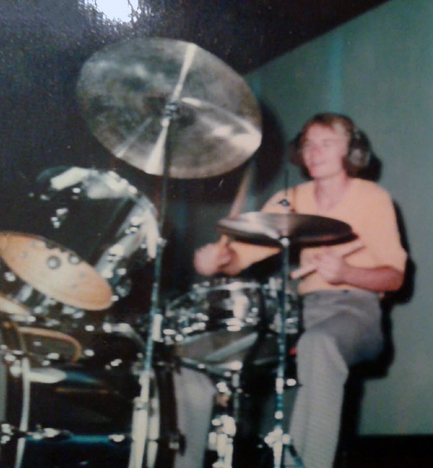
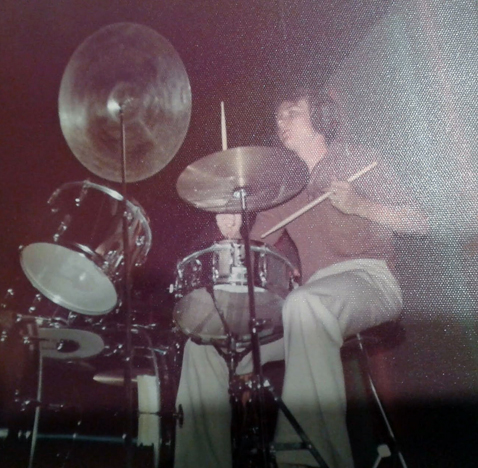
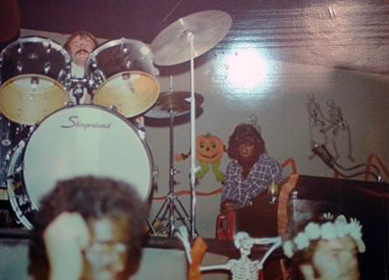
This last one was taken on Halloween 1976; Dean was Sonny to his girlfriend’s Cher, and DJ Larry Davidson was the Wolfman.
1976
STEVE McCLELLAN
It’s now May 1976, and with it comes the hiring of new General Manager Stephen Thomas McClellan. You’ll have to indulge me as I present a longer profile of the person who became the heart and soul of Uncle Sam’s, Sam’s, and First Avenue.
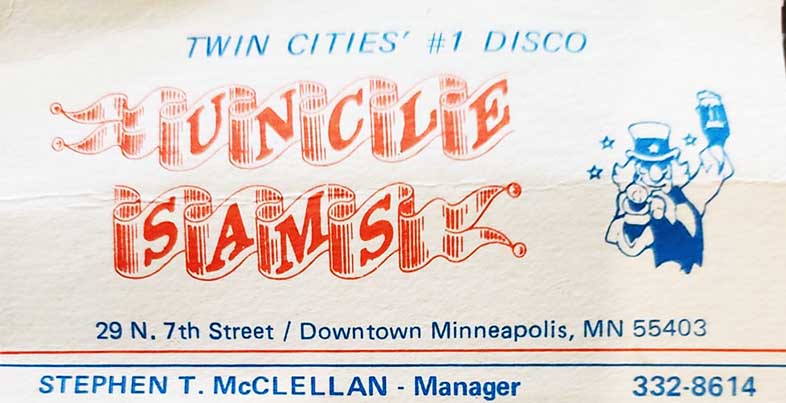
Courtesy Steve McClellan
Matos:
Steve McClellan wasn’t punk. The first time he stepped foot into 701 First Avenue North, when it was still a Greyhound depot, he was a teenage runaway hightailing it to San Francisco during the summer of 1967 because, he says, “My dad was going to make me cut my hair.” The Nebraska Highway Patrol sent him back. “I could see my dad glaring at me across the lot,” says McClellan.
In 1968 he enrolled at the University of Minnesota during a heady period of social change: “I’ve only voted for two major-party candidates in the last 40 years: George McGovern [in 1972] and Obama [in 2008],” he says. “I was third party all the way.”
McClellan loved rock ’n’ roll in high school, having seen the Yardbirds on the eighth floor of the downtown Dayton’s department store, but gave his records to a neighbor upon entering college. He had his eye on a career in public service, researching legislation for the city coordinator (1974), and nursing ambitions to join Ralph Nader’s organization. He spent three years on the state board of directors of the Minnesota Public Interest Research Group (MPIRG), three years on the local board, and edited the MPIRG newsletter for two years(February 1973 to December 1974). He recalls thinking, “I was no longer going to waste money or time on music.”
He was wrong. In July 1973 he took a part-time [job as a barback, or bartender’s assistant] at Uncle Sam’s. McClellan got the job alongside an old friend from De La Salle High School, the straitlaced Jack Meyers.
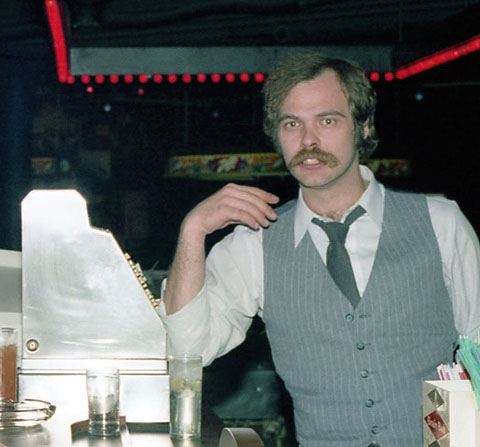
Steve in 1979 – adorable photo copyright Steven Laboe
In June 1975 he was rushed into management training, as he was transferred to American Scene’s Lincoln disco to become an Assistant Manager. And in May 1976, he returned to Minneapolis to start his long run as General Manager of Uncle Sam’s, then Sam’s, First Avenue, and 7th Street Entry, most names of which he created himself. By 1977 he was American Avents’ Rookie of the Year.
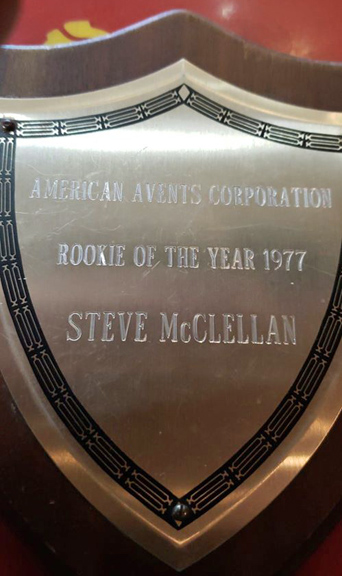
When asked to describe Uncle Sam’s in the mid ‘70s, Steve replied:
Blue-collar disco. Shag purple carpeting to match the Vikings’ motif. It was very mainstream – a blue-collar disco run by a bunch of people out of Cincinnati that had a real long-range vision of something that was going to die in three years. (Current 2014)
Matos:
Four years later, McClellan booked Nick Gilder and Starbuck, figuring they would be easy draws since each had #1 hits that year (“Hot Child in the City” and “Moonlight Feels Right,” respectively). Both tanked. “I paid too much and lost money,” says McClellan.
He had better luck a year later when, back-to-back, he booked Pat Benatar and the Ramones. Both were rousing successes, and American Events [by then Avents] noticed. “They let me do whatever I wanted after that, ’cause I sold out two shows like I knew what I was doing,” says McClellan, who was nevertheless surprised by the Ramones’ sellout. “I thought, They don’t even have a [hit] record out. How come people are buying these tickets? There was something exciting going on.”
. . .
But McClellan wouldn’t cut costs on bands. “I wasn’t looking at it in terms of a business plan. I was coming out of ’60s radicalism,” he says. “The only reason you exist is to make change. That’s why I was so hard on pure pop bands: I had no time for bands that didn’t have a message.”
In his book Hi Jinx and Hearsay, City Pages and Twin City Reader scribe Martin Keller wrote,
In my experience, McClellan was one of the smartest, most enthusiastic music lovers ever to run a joint. He had earned the respect of industry veterans, writers and reporters, and legions of musicians and music fans from across the diverse spectrum he brought to the stages of the main room and the Entry. He wasn’t fondly called “Chainsaw” by rock writer P.D. Larson for nothin’ either: Steve’s buzzing manner could silence the unaware.
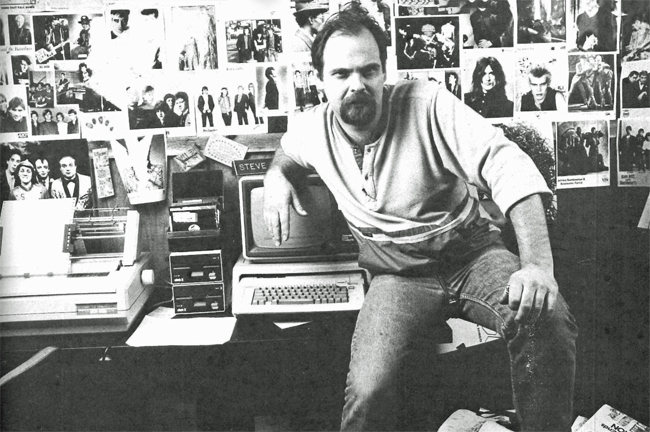
Corporate Report MN, August 1, 1985
A 1990 profile of him in a feature called “The Most Influential Movers and Shakers of the Twin Cities Music Community” has this to say about Steve:
A teddy bear in wolf’s clothing, McClellan has run First Avenue with a heart of gold and an iron fist. Hist tirades are legendary; his sincerity and grief-giving abilities seemingly boundless. While he’s quick to deflect praise to his support staff, over the past eleven years First Avenue/7th St. Entry has remained the Midwest’s most vital new music venue, due in no small part to McClellan’s energy and his willingness to take an active role in nurturing local music.
Steve takes no credit for the success of First Avenue, and insists that he relied on others for advice on which bands to book. Another factor in the mix was that the size of the venue precluded the big acts more suitable for arenas, and the major booking agencies were not interested in the club. As a consequence, he ended up working with smaller agents and record companies like SST that were more than happy to book their bands at the premiere club in town. Locally he often consulted people in the know like Peter Jesperson at Oarfolkjokephus, Jimmy Jam and Kevin Cole at the downtown Hot Licks, and Bob Mould of Husker Du. (Current 2014)
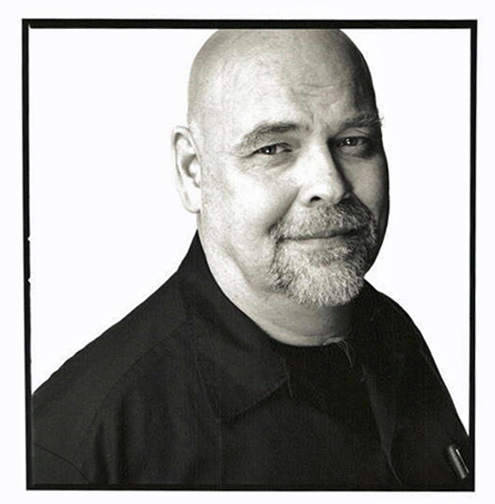
Matos:
Looking back, he says, “I never really booked shows as moneymakers. Sometimes we’d cross over to a new audience, just ’cause it was good music. I was serious about that.”
In 2015, both Minneapolis and St. Paul declared Steve’s 60th birthday “Steve McClellan Day.” The text of the Proclamation is included in the Appendix at the very end of this document. Love you, Steve!
CHRISSIE
And yet, behind every great man is an even greater woman, and in this case, that woman, was Chrissie Dunlap. As a fellow power behind the throne, I can just imagine how this woman kept Steve organized and kept the whole machine running. I wasn’t there, but I’ve heard enough stories – from Steve himself, included – to know that she was an integral member of the team.
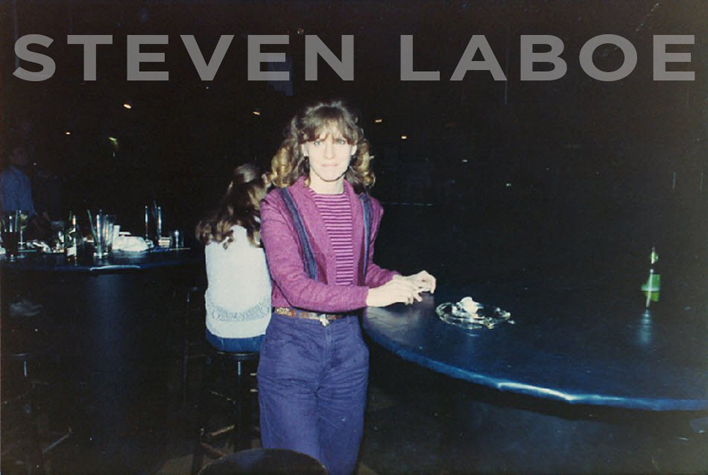
Chrissie Dunlap – Photo copyright Steven Laboe
ENOUGH ABOUT STEVE
Back to our regularly scheduled website.
June 21, 1976: Jesse Brady
BRIAN AUGER
On July 20, 1976, Uncle Sam’s hosted Brian Auger and his band the Oblivion Express. Jesse Brady opened the show. Skip Jones’s review described the scene as “half price drinks, thick smoke, and loud, loud music.” Jesse Brady was moving into something called “sophistarock,” or maybe “half-baked,” although it made no difference to the girls in front.
At 11:00 Auger appeared and the crowd ate up the British organ and keyboard God’s performance. Jones ended his review with “Hats off to Uncle Sam’s for some good live music and let’s all hope for more of the same.”
In the review, much was made of the difficulty Jones had in locating manager Steve McClellan in the huge building. McClellan was quoted as saying he had only been manager there for six months. (Review: Insider, August 1976)
DISCO ARRIVES
The advent of Disco with a capital D is a matter of discussion.
In June 1976, the Insider approached the topic of Discos in a big way with a two-page article called “Slumming the Din Bins: A Convoluted Guide to the Discoplex.” It explained that discos were the “legitimate offspring of the illegitimate bath scene in New York” that finally reached the Twin Cities a year-and-a-half later. Rock or country was still preferred over the Ohio Players, but the hustle and the bump were in play.
The reporters (Pete Dwyer, Thomas Rusch, and Susan Winter) took a field trip to a few downtown Minneapolis discos, which I will list but not describe:
- Zelda’s
- Gay Nineties
- Sutton Place
- Othello’s
- Moby Dick’s
Their review of our venue was savage and hilarious:
Uncle Sam’s is just plain disgusting. The crowd is very young and suburban, but not necessarily hip. They apparently like loud, loud music, and that it is. If you retire to the glass encased upstairs lounge, the volume is bearable, but you’ll have to wipe the smoke off your table. The problem at Sam’s is two-fold. The crowd at Sam’s is there for the cheap drinks (various specials on week nights) and they dance to keep up their thirst. The management responds with cheap drinks, and deteriorating sleazy decor and music that reflects the crowd’s taste. Our evening ended with a slow grind as we watched what looked like the younger half of the city of Richfield dancing down to the tune of early Beatles’ hits. What hath this disco craze wrought.
As for me, I remember sitting upstairs one night in 1976 and hearing something foreign to my ears. I did not like it. “What the hell was that?” I asked. Born too late, I was a child of the ’70s – fortunate to be 18 when the drinking age was lowered to 18, but subject to music I found to be boring. At least there were “famous movies and slides” for people to watch when the dancing got too dull.
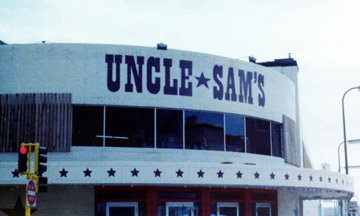
One good hint of when Disco came to Uncle Sam’s is Jon Bream’s article, “DISCOS: ‘Dancing Madness’ – It Goes Bump in the Nightlife,” published in two parts in the Minneapolis Star on October 13, 1976.
On October 13, 1976, Bream wrote an analysis and history of the music. He wrote that the phenomenon started on the east coast two years earlier, had finally made it to the Twin Cities, and that over a dozen full-time discos were prospering locally. He traced the first disco music to the summer of 1974.
CR also cites 1974 as the advent of the “first big wave of disco hits,” with songs such as:
- “Kung Fu Fighting” by Carl Douglas
- “Don’t Rock the Boat” by the Hues Corporation
- “Waterloo,” by ABBA
- “Rock Your Baby” by George McCrae
- “Never Can Say Goodbye,” by Gloria Gaynor
On October 14, 1976, Bream profiled 11 full-time local discos, including Uncle Sam’s:
Admission: $1 Drinks: About $1
Uncle Sam’s is a sensory experience. Patrons are blitzed by thunderous music, slide shows, films, a revolving, mirrored ball, a panoply of blinking lights, colored lights shining underneath an elevated, translucent dance floor and a drummer who plays along with the music.
Uncle Sam’s downtown’s biggest bar, is easily the largest disco in town. It’s where the action is for the white, under-25, blue-jean crowd. The huge place, which is a converted bus depot, is usually packed on weekends. People come to dance, play in the game-room (Foosball, pinball and pool are available), drink or talk in the plexiglass-enclosed, almost soundproof balcony.
Uncle Sam’s musical selection seems more dance-oriented than disco-chart oriented. Included are top 40 disco hits by such performers as K.C. and the Sunshine Band and Silver Convention as well as rock classics by the likes of Led Zeppelin and Aerosmith.
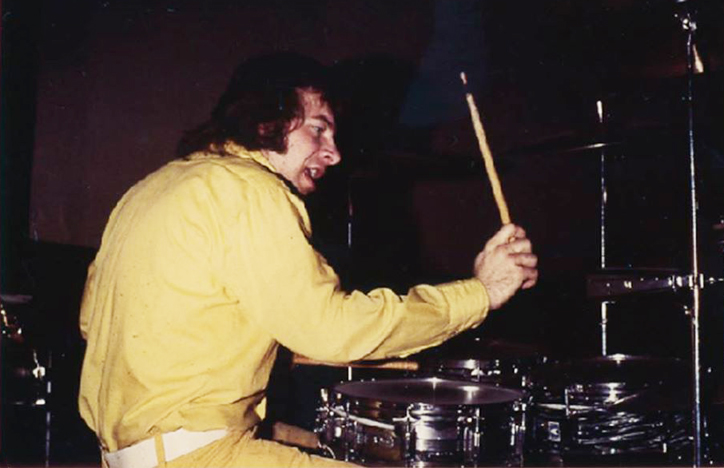
“Danny the Drummer” in 1977 – photo copyright Steven Laboe
On September 1, 1976, the drinking age in Minnesota was raised from 18 to 19, with previously enfranchised 18-year-olds grandfathered in.
October 10, 1976: Berlin and Raggs
October 24, 1976: Visage
October 25, 1976: Jesse Brady
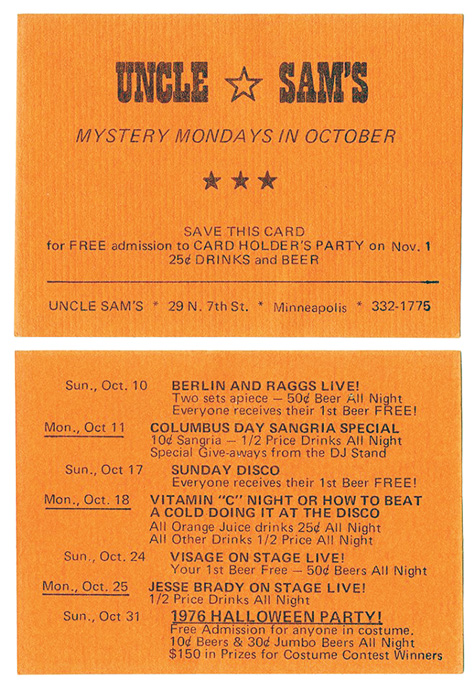
Courtesy Barb Economon
November 1, 1976: Dwight Twilley Band, opened by The Boys and the Suicide Commandos.
November 7, 1976: Archangel
On November 23, 1976, Brian Auger and Oblivion Express made a repeat performance, opened by Lamont Cranston.
A review by Harvey Ginsberg (December 3, 1976) complained that Lamont Cranston’s opening set was “overextended” and that Auger was delayed by an hour due to sound difficulties: “both the beer and music were becoming flat and the pack’em-to-the rafters policy of the club was causing more aggravation than excitement.” But when things were straightened out, the band gave out with a 90-minute set starting with “Brain Damage,” that those kids are probably feeling today. Or at least eardrum damage. The band included Jack Mills on guitar, Clive Sharmer on bass, Auger on Hammond organ and electric piano, Mike Clark on drums, and Lenox Langton on congas, with Alex Ligertwood on vocals.
November 24, 1976: Judd
November 25, 1976: Cain
In November 1976, Minneapolis police were allowed to moonlight as bouncers at clubs but not at the Flame, Moby Dick’s, or Uncle Sam’s. “They cater to kind of a wild crowd,” the Deputy Police Chief was quoted as saying. (Minneapolis Star, November 29, 1976).
December 5, 1976: Hamilton, Joe Frank, and Dennison. The dangers of naming your band after its members is demonstrated here – what happened to Reynolds? Wikipedia: “The group first hit the charts in 1971 with ‘Don’t Pull Your Love.’ Reynolds left the group in late 1972, and was replaced by keyboardist Alan Dennison, but the band kept the name ‘Hamilton, Joe Frank & Reynolds’ until 1976. This revised line-up performed the group’s biggest hit, 1975’s ‘Fallin’ in Love.’ The headliners played two 45-minute sets, reported the Insider. The show was opened by Stone Ground.
December 26, 1976: W.H.I.M. Winter Warmer, music by Raggs, Wolf Brothers, and Spontaneous Combustion. W.H.I.M. was a telephone service where you could call and find something to do.
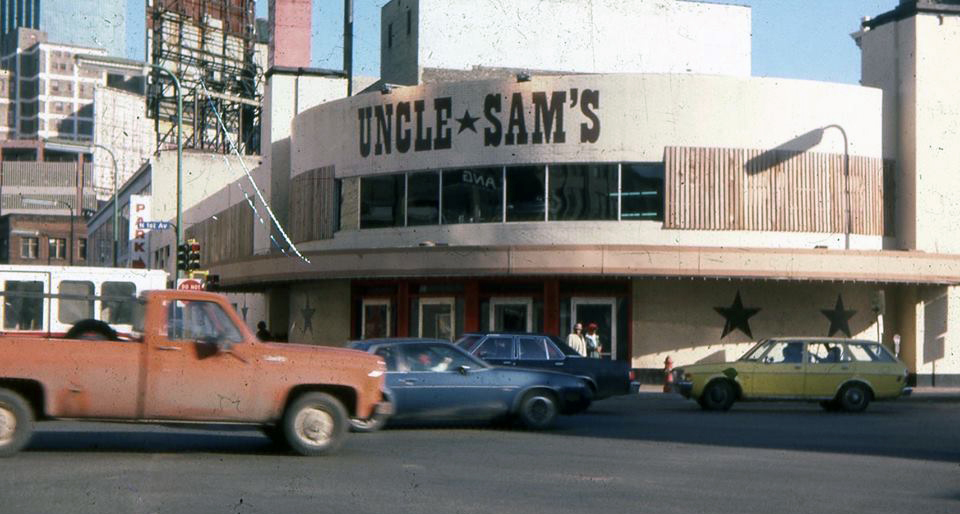
1976 Photo by Andy Watson courtesy Alan Freed
1977
Revolver performed at Uncle Sam’s on January 30, 1977
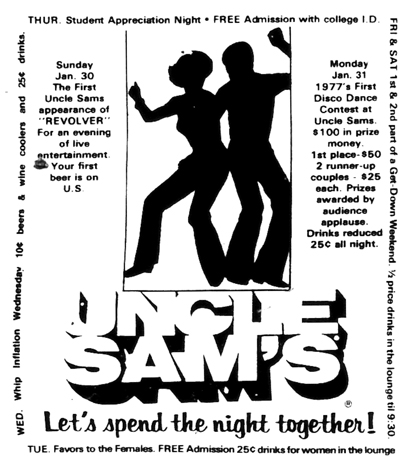
Twin City Reader
March 28, 1977, featured three bands at Uncle Sam’s: Zachariah, Visage, and the ever-popular Cain.
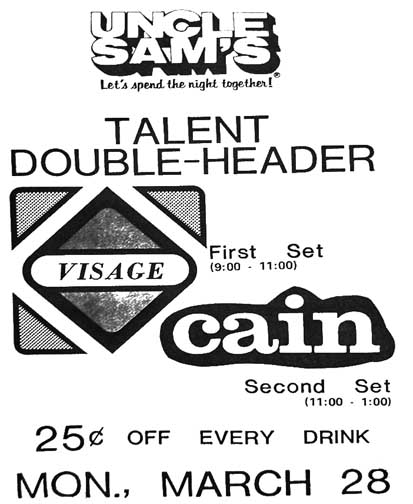
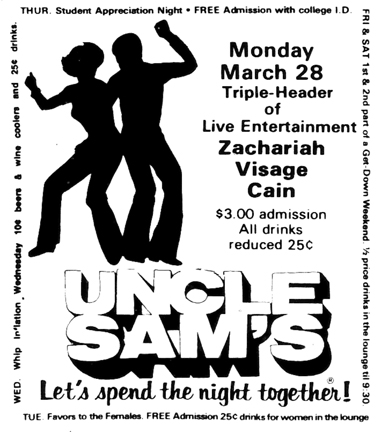
Twin City Reader
On June 27, 1977, Cain celebrated its release of its second album, Stinger, at Uncle Sam’s.
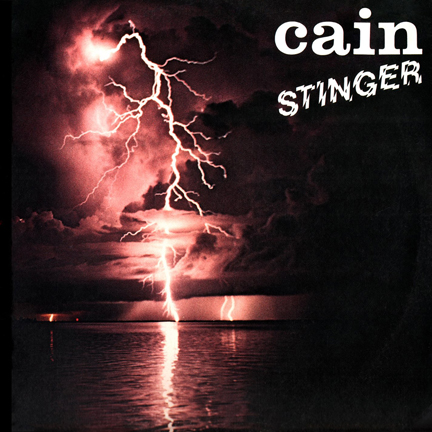
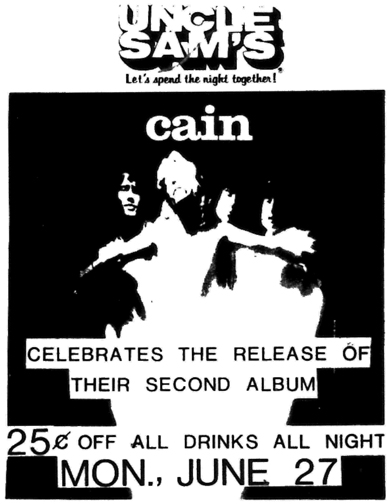
Twin City Reader
Uncle Sam’s went all out to promote its theme. Corporate in Ohio even sent an Uncle Sam’s costume, which was usually worn by Stan Himes. Here’s Stan in 1977:
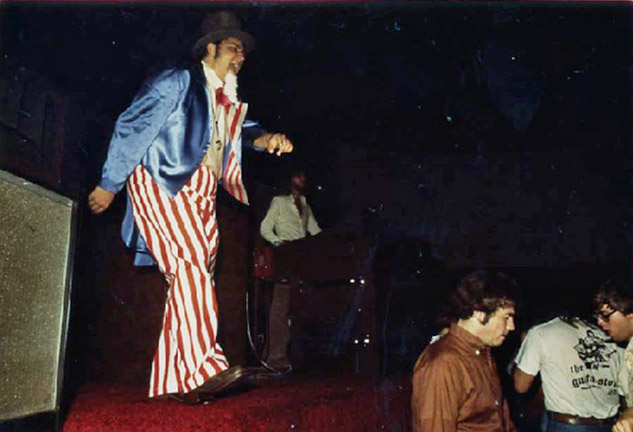
Photo copyright Steven Laboe
July 25, 1977: Tornader was apparently a group from Spain that specialized in “Jazz-Funk, Soul, Disco” on their 1977 LP “Hit it Again,” according to Discogs. Laura Fissinger of the Insider reviewed the show and was deeply disappointed in Tornader, although apparently not as much as in opener Vissage, which she called “local purveyors of metal ineptitude.” Ouch.
An article about local discos characterized Uncle Sam’s as “the teen-ager’s disco,” with 90 percent carded at the door. It drew 500 people on weekday nights and up to 1,000 on weekend nights. The article reported that 60 percent of the music was rock ‘n’ roll and 40 percent disco, with more slow songs than at most discos. [I remember a tradition of a kiss at the end of every slow song.] (Minneapolis Tribune, November 4, 1977)
November 30, 1977: Judd, from Mankato. Laura Fissinger’s review had a fair amount of criticism of the band and its current LP, but high praise for lead singer Steve McLoone, “who looks more like a state U fraternity boy than the laudable pop singer he is.” Both his stage presence and vocal delivery had “sparkly exuberance,” she noted, and she said that “If this guy doesn’t get a chance to croon over America’s car radios it will really be a shame. His is the perfect pop-rock voice.” (Insider, January/February 1978)
SATURDAY NIGHT FEVER
Disco got a kick in the hot pants with the release of the film “Saturday Night Fever” on December 16, 1977. The movie was originally shown in just a few theaters as shown in the ad below.
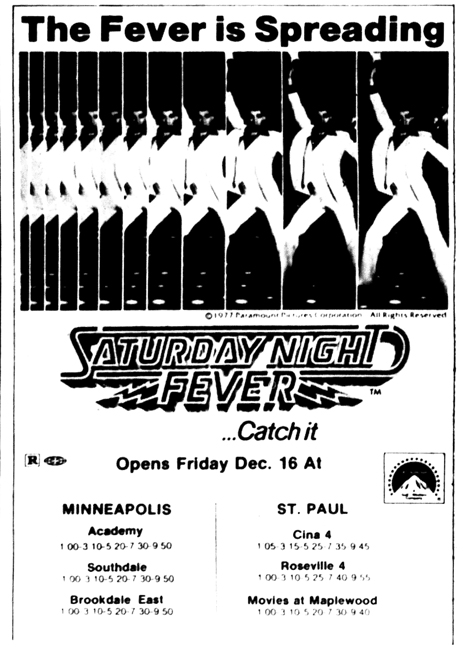
Twin City Reader, December 15, 1977
1978
On March 17, 1978, several local night club managers were interviewed in the Minneapolis Star about the impact of the film. Steve McClellan:
Anybody would be crazy to say the movie hasn’t had an effect. Especially the Bee Gees soundtrack. The best way to see what I’m talking about is to come see the excitement when we put that music on. A thousand people head for the floor.
We ran a “Saturday Night Fever” dance contest last month and all we did was run one ad. Our crowd jumped from the usual 1,200 to 1,600 that one night.
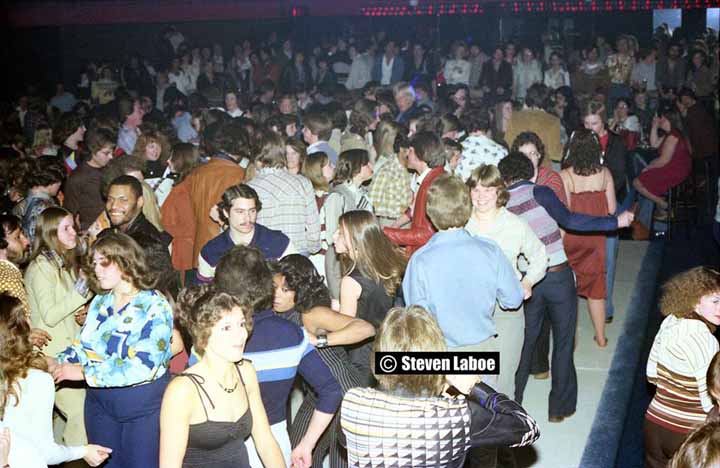
Crush of Humanity – Saturday Night Fever Dance Contest, February 1978. Photo copyright Steven Laboe
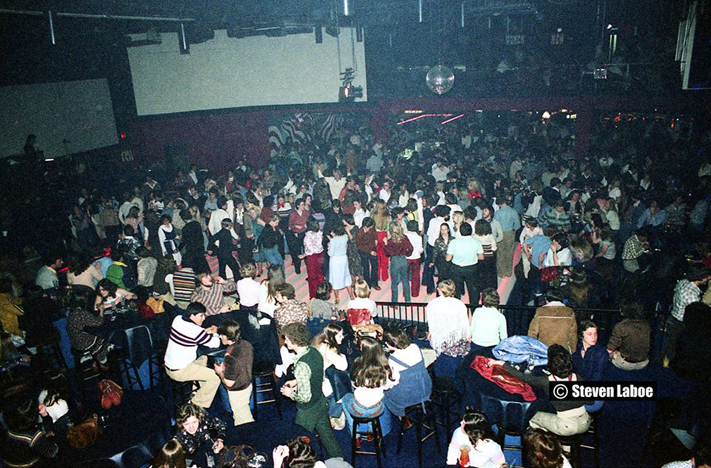
Saturday Night Fever Dance Contest, February 1978. Photo copyright Steven Laboe
ROCK EXTRAVAGANZA
Thanks to Johnny Rey, who posted this ticket that tells us of this fabulous event starring four ** count ’em ** four bands! For $1!!
- Star-Flight
- Sterling
- Flamingo (Johnny’s band)
- Visage

TEEN SUNDAYS
In June 1978, Karin Winegar wrote a long article about Uncle Sam’s, describing the club’s liquor-free Sunday nights, open only to teens. Admission was $3, and the hours were 7 to midnight during the summer and 6:30 to 11 during the school year. No one over 19 was admitted, “vigorously enforced by manager Steve McClellan, 28, and his muscular doorman, Richard Lukas, 24.” (Minneapolis Star, June 26, 1978)
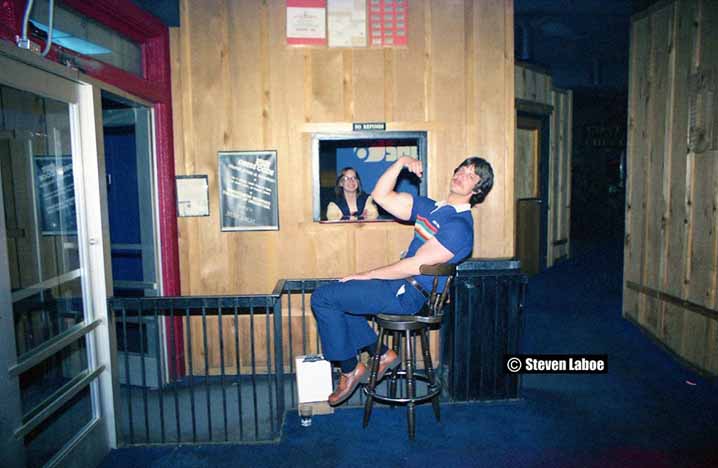
Bouncer Richard Luka, aka Dix Steele, and Cashier Deb Tinel, 1977. Photo copyright Steven Laboe
When teen night was initiated the year before it was met with nervousness by the City Council and the police, but during the first three summer months, attendance grew from 300 to 1,200. School administrators disapproved, “but Sundays we have a full house, anyway, and there’s more energy here on this night than on the rest of the week put together,” said McClellan.
Bouncer Luka touted the over-19 ban as protective: “Older guys who think it’s easy pickin’s with young girls, men who want to push kids around or sell drugs are just eliminated at the door.” He and McClellan, along with undercover floor staff, remained alert for kids with smuggled booze or marijuana, or “attempts by ‘Hennepin Avenue punks’ to gain entry.” Kids that smell like liquor or are deemed to be troublemakers are ejected.
While there are a few kids in the grade school age levels, most of the clientele were in high school. Fashion mattered, as they modeled their “jeans, espadrilles, and gypsy frocks.”
And one nice tradition prevailed, as it was reported that the “boys still ask the girls to dance most of the time.”
Longtime DJ Kevin Cole was hired in the Fall of 1978. Cole didn’t play exactly the kind of music prescribed by American Avents, which was checking up on its clubs by requiring them to submit tapes of its programs, so Kevin submitted fake tapes. (30th)
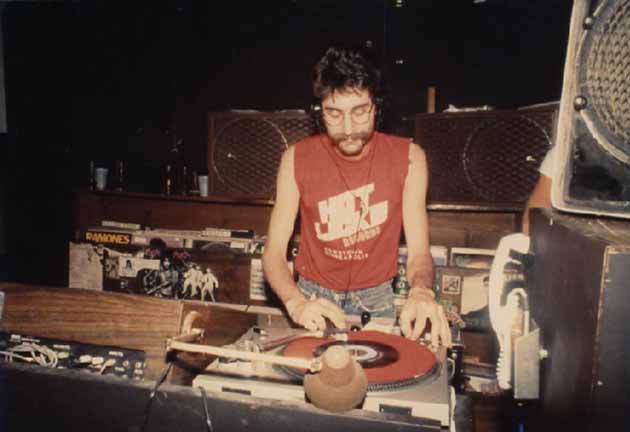
Kevin Cole, Summer 1979. Photo copyright Steven Laboe
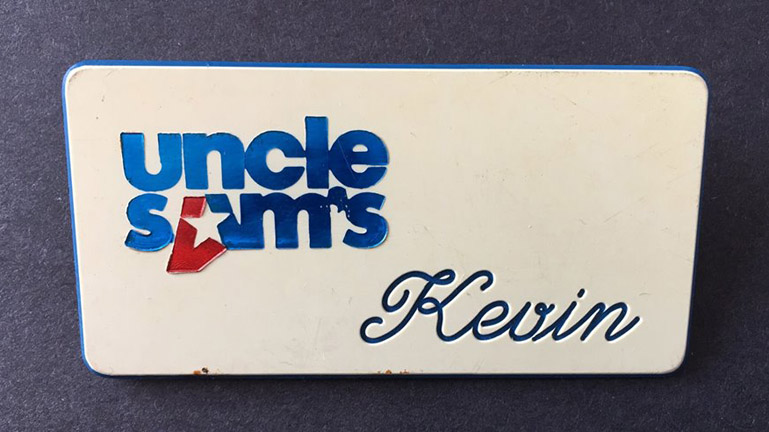
Image courtesy Kevin Cole
Here’s another shot of the DJ’s lair:
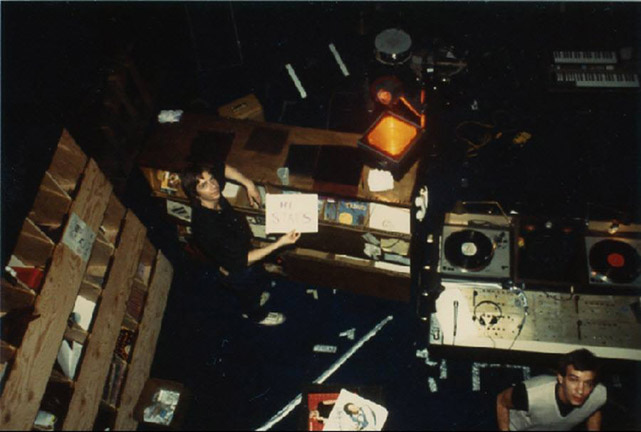
Photo copyright Steven Laboe
MIND AND MATTER
A group called Mind and Matter performed at Uncle Sam’s in about October 1978. Members of the group include Turhan Bey (not the movie star from the ’40s) and Ira “Smitty” Smith. A 19-year-old Jimmy Jam was in the band. The performance was taped and shown on the first episode of a KSTP program called “Steamroller,” hosted by Marc Goldstein and Molly Lynch. The episode was aired on December 22, 1978, and can be seen Here. Thank you to show producer Ossian Or for the information on the show! I found a few other performances of Mind and Matter ranging from 1976 to 1979.
Things were apparently getting weird; in an article about Hennepin Ave., Uncle Sam’s was described as “the kind of place where you might have thought the girl in the giant bunny ears was strange until you realized that she was dancing with a guy in a diaper.” It was Halloween, after all! (Minneapolis Star, October 30, 1978)
November 20, 1978: Jesse Brady
Steve McClellan remembered booking Nick Glider and Starbuck in 1978, but nothing came up in the Strib database. (Matos)
1979
In about 1979 the Uncle Sam’s logo was changed to incorporate a star where the A had been.
Matchbox images below courtesy Kevin Cole.
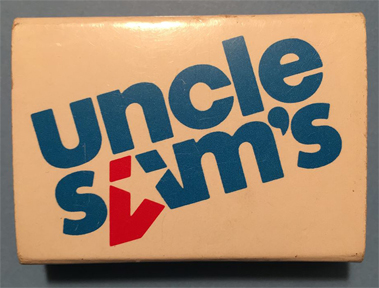
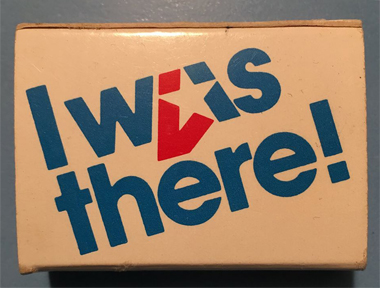
FIRECRACKERS
Firecrackers were the signature drink at Uncle Sam’s – I was too busy dancing to drink one. The clear ones are what I remember – the red ones are with the redesigned “A.”
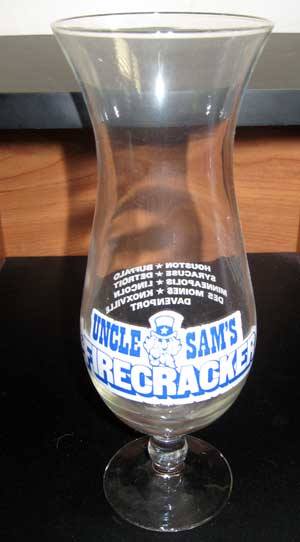
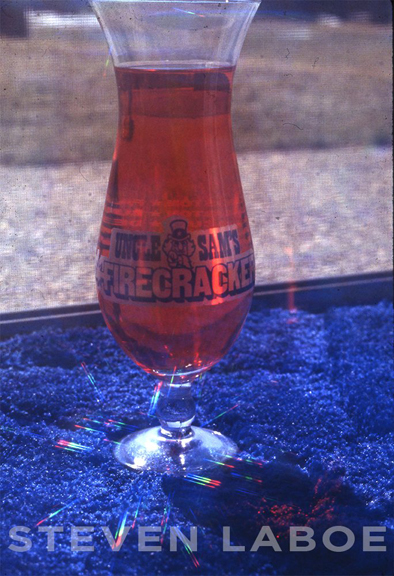
Here’s a full one; photo copyright Steven Laboe
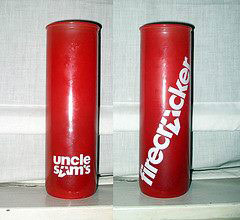
On March 17, 1979, DJ Kevin Cole refused to beat a tambourine and blow a whistle while he spun records, so he was fired. He was replaced by Roy Freedom (nee Freid), from the Rickshaw Room at Howard Wong’s on 494. Freedom immediately hired Cole as his backup. (30th)
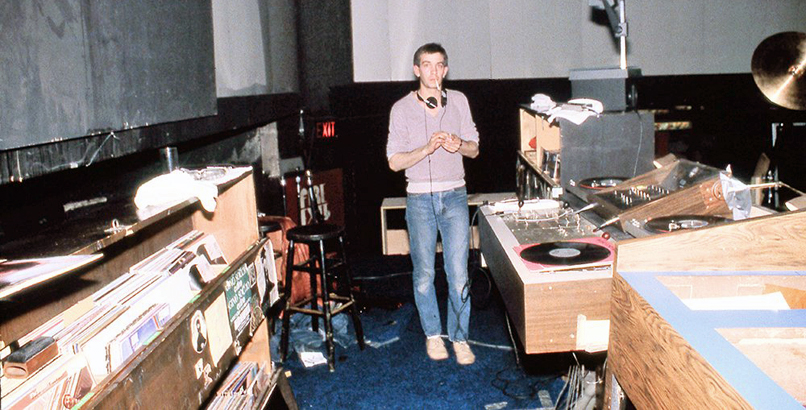
Roy Freid, 1979. Photo copyright Steve Laboe
These were the days when the DJ booth was front and center on the stage.
April 14, 1979: The Easter Hop was a big enough affair to merit these cool invitations!
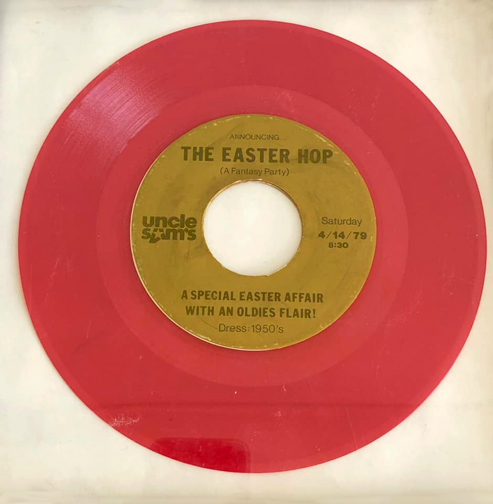
Image Courtesy John Kass
Steve McClellan was quoted as saying that when “Saturday Night Fever” first came out, the club saw 6,000 people per week. Currently the count was about 4,500 to 5,000 per week. (Minneapolis Tribune, July 28, 1979)
DISCO SUCKS
Uncle Sam’s ran an ad in the August 1979 edition of Sweet Potato (the precursor to City Pages) announcing a series of Wednesday night concerts. The ad also said, “We’ve thrown out the Disco, the Dress Code, the regular drink prices and we’ve opened the doors. An Apple Production with you in mind.”
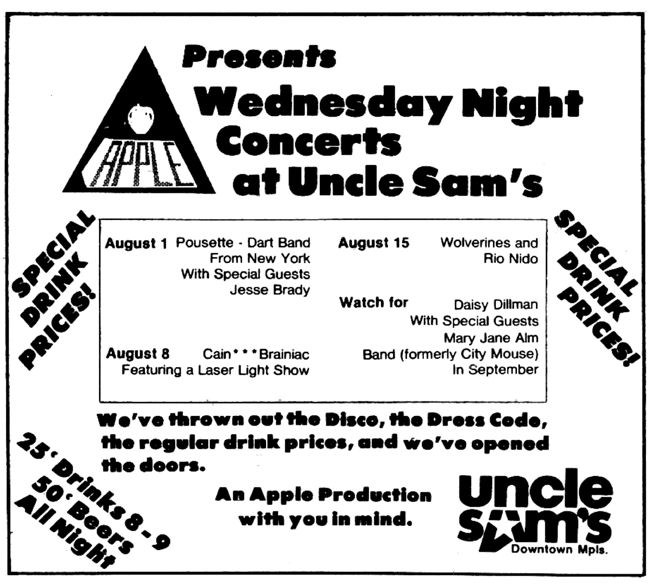
Sweet Potato, August 1979
August 1, 1979: Pousette-Dart Band from New York, with Jesse Brady
August 8, 1979: Cain and Brainiac, Featuring a Laser Light Show
August 15, 1979: Wolverines Classic Jazz Orchestra
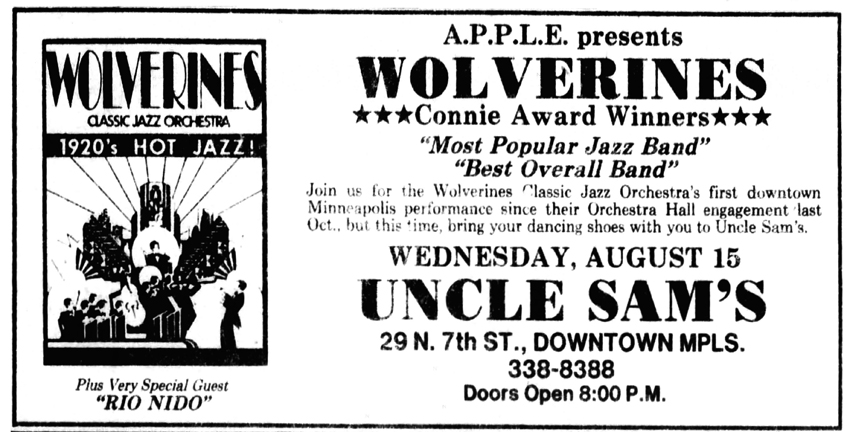
September 5, 1979: Daisy Dillman with the Mary Jane Alm Band (formerly City Mouse)
September 12, 1979: Jesse Brady with Fairchild
September 19, 1979: Daisy Dillman with Special Blend
September 26, 1979: Mission Mountain Wood Band, and introducing Tune
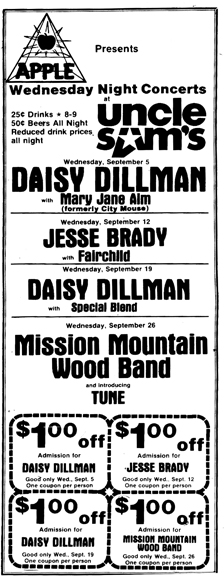
Sweet Potato, September 1979
October 3, 1979: Pistons, with Fusef
October 31, 1979: Daisy Dillman
November 26, 1979: KMOJ and KFAI held a benefit to “cure the winter blahs” and raise money for the two non-profit radio stations. Performers were Willie and the Bees, Vicky Mountain, and the John Einweck Band.
November 27, 1979: Daisy Dillman with Caribou
THE DAY DISCO DIED
November 28, 1979 was the first of three times the Ramones came to the venue before it became First Avenue, although it was not the band’s first appearance in Minneapolis. Jon Bream found the first 30 minutes fun, but after that the show got boring. (Review December 4, 1979). The Hypsterz opened the show.
Although it wasn’t a planned or cut-and-dried transformation, Chris Riemenschneider pinpointed this night as the one that began the end of Disco’s hold on Uncle Sam’s (Star Tribune, October 28, 2017):
[A] pivotal turning point came Nov. 28, 1979, when four black-leathered punk rockers from Queens broke through the flashy red-white-and-blue Uncle Sam’s sheen and destroyed the disco era at the club.
. . .
Longtime house DJ Kevin Cole also considers the Ramones gig the big-bang moment for the club’s post-disco existence. “It meant a lot,” recalled Cole, one of the hip record-store clerks helping McClellan steer the club into its new incarnation. “To have them in our venue was remarkable, and it sold out! We were onto something.”
PAT BENATAR
November 29, 1979: Pat Benatar, opened by Curtiss A
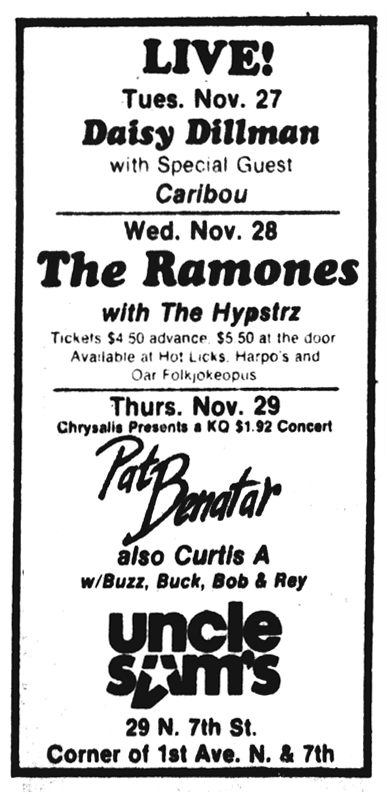
Minneapolis Tribune ad, November 25, 1979
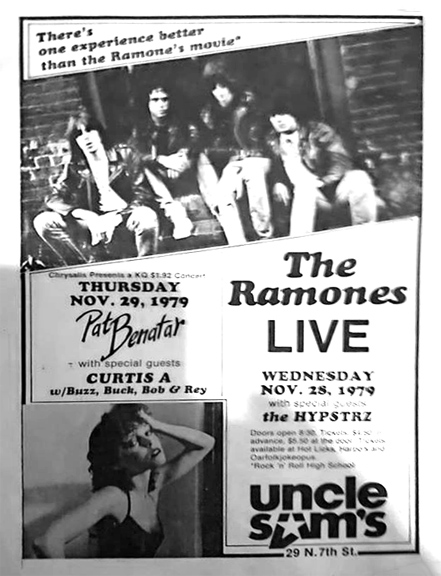
From John Kass:
Uncle Sam’s corporate had a fanzine-style monthly newsletter with club sales tips and suggestions that was distributed to all locations around the country, directed at club managers. This issue praises the Minneapolis branch for ticket sales at the Ramones and Pat Benatar shows, and for the “Rock Revival Weekend”- it’s a “good idea.”
The issue below was from just before “the company was dumping the Minneapolis Franchise,” in the words of Steve McClellan.
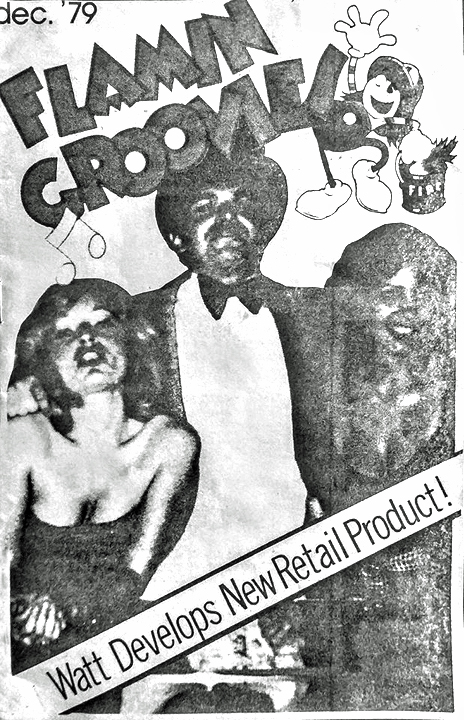
Courtesy John Kass
Disc Jockeys Roy Freedom and Kevin Cole were encouraging the transition to what was then being called “New Wave” music, as evidenced by these special shows they hosted on November 30 and December 1, 1979.

Image courtesy Kevin Cole. From First Avenue: Minnesota’s Mainroom by Chris Riemenschneider, MNHS Press, 2017
December 1979: Tuesdays were Ladies Nights, with fashion shows and male dancers.
December 5, 1979: Whiskey River with the North Country Band
December 26, 1979: Whiskey River with Daisy Dillman
EXIT AMERICAN AVENTS, ENTER 2M
It is unclear when American Avents (the original American Scene, then American Events) and The Committee officially terminated the Entertainment Franchise Agreement under which they operated, although it is estimated to be the end of 1979. The reasons for the retreat of American Avents have variously been explained as:
- American Avents was going into debt, and decided to drop several of its clubs, including Minneapolis, at the end of the year; (30th)
- Disco was dying, Uncle Sam’s was getting sleazy, and it had a reputation of attracting minors; Allan asked American Avents to leave; (CRM)
- American Avents wanted to focus on more upscale venues, and lost interest in its more blue-collar clubs (SM).
The exit of American Avents meant that management of the club reverted back to the Committee, whose sole shareholder was Allan. Steve McClellan and Jack Meyers formed a corporation and signed a contract with (Allan/the Committee – at this point they were the same) to manage the club. (More details about 2M Inc. are in Section IV.) Steve was the General Manager with all the responsibilities and freedom to make decisions.
1980
January 2, 1980: Yipes! with Curtiss A and Smart Alex
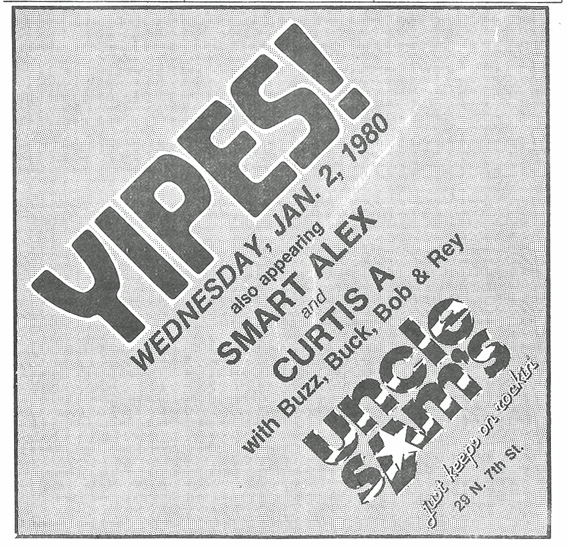
Twin City Reader ad courtesy Errol Joki
January 9, 1980: Bad Boy, with Soda
January 16, 1980: Sussman Lawrence, with the Tropics
January 23, 1980: Dare Force, with Jiggs Lee and Fragile, and Dame
January 30: Johnny Holm, with Gadband and Home Free
February 6, 1980: Tommy James Postponed to May 29, 1980
Mid-March, 1980: Mud Wrestling came to Uncle Sam’s
March 19, 1980: Gang War included Johnny Thunders of the New York Dolls and Wayne Kramer of the MC5. Gang War would return in October.
DANCE FEVER
At some point in 1980, Deney Terrio and Janet Jones from the TV show “Dance Fever” came to Uncle Sam’s to recruit dancers for the show. Janet was a member of “Motion,” Terrio’s backup dancers on the show. There was a contest at the club, and if memories are correct, some couples did go on to Hollywood to audition and perhaps perform on the show. An exact date is not available, but Steve Laboe took some shots of the action.
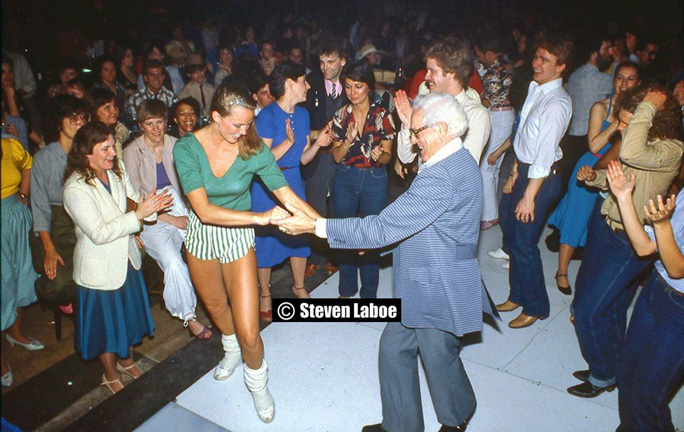
Janet Jones and friend after the contest. Photo copyright Steven Laboe
Jones went on to star in “Grease II,” “The Beastmaster,” and “Police Academy 5.”
The photo below shows the winning contestants. The last three people on the right are Deney Terrio, Janet Jones, and presumably some Class C Celebrity judge.
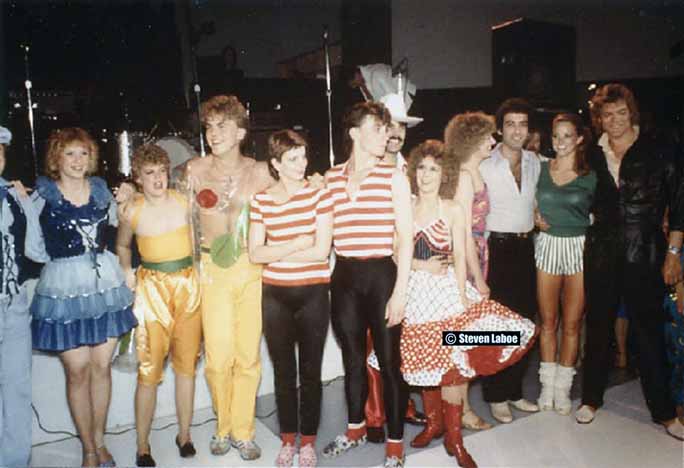
Photo copyright Steven Laboe
7th STREET ENTRY
On March 21, 1980, club manager Steve McClellan started booking live acts in a smaller part of the building that used to be the bus station’s restaurant and Uncle Sam’s game room and then checkroom.
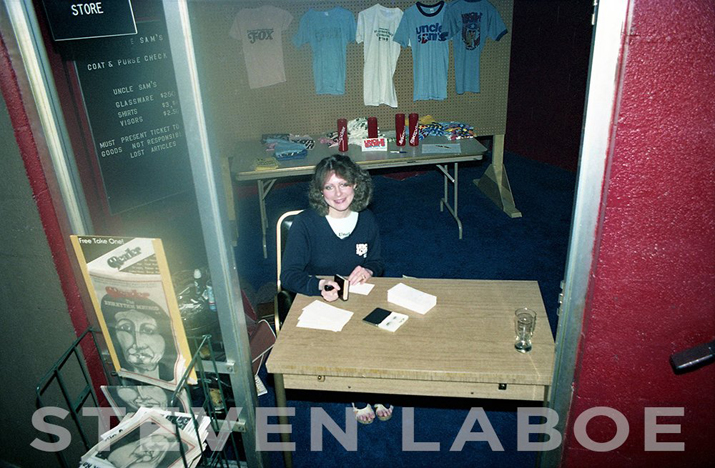
Jodie Penhollow in 1977, working the Souvenir Shop which would eventually become the mainroom access to the 7th Street Entry. Photo copyright Steven Laboe
There was a soft opening when Gang War played the Entry the night after they played the Mainroom, with Husker Du opening. (30th)
The first official act in the new room was Curtiss A, opened by Wilma and the Wilburs. Shows at the Entry are not listed on this site. (30th)
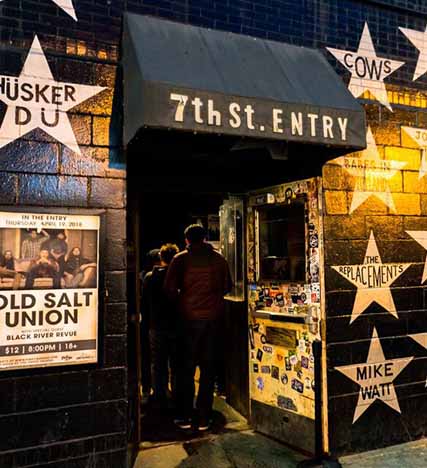
SAM’S: 1980 – 1981
One of the first things that the new management did was change the club’s name from Uncle Sam’s to Sam’s. I didn’t find a formal notice of the name change in the paper, but based on ads, it appears to have happened between April 18 and May 4, 1980.
The change to Sam’s was accompanied by the redecoration of the club in Early Punk Black. The neon dance floor and light wall was torn up, and some of the neon was hung in the ceiling. Steve McClellan said, “Jack Meyers did a FANTASTIC job converting what most clubs would have tossed into the dumpster – but instead turned into usable ‘new’ features.” The neon stayed there until about 1983.
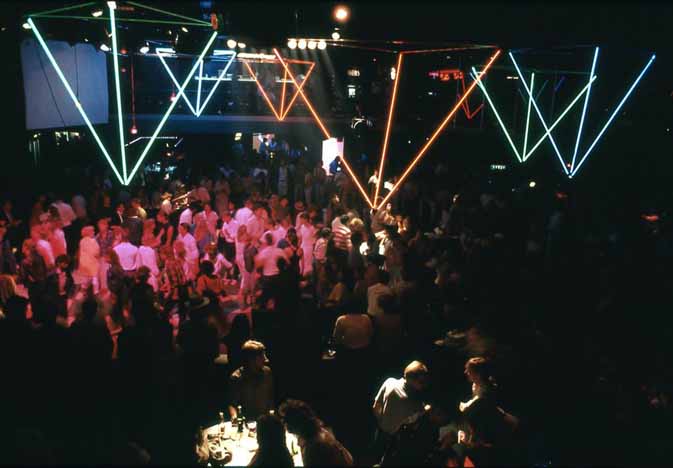
1982 photo copyright Steven Laboe
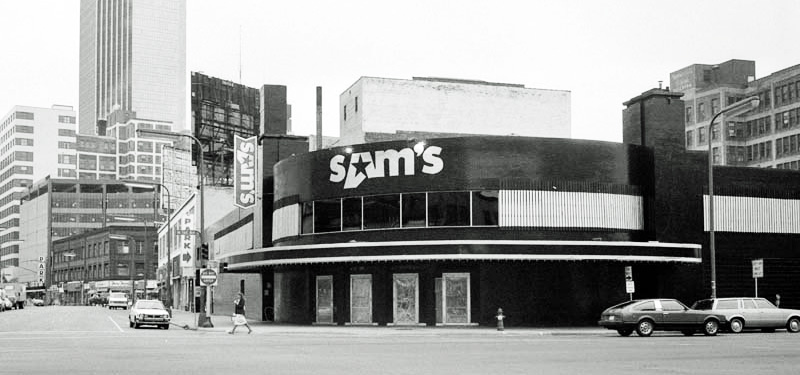
Photo courtesy Stephen Cysewski
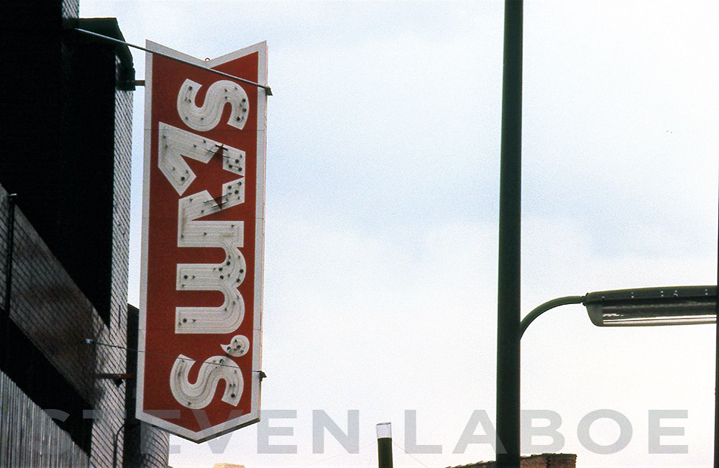
Photo copyright Steven Laboe
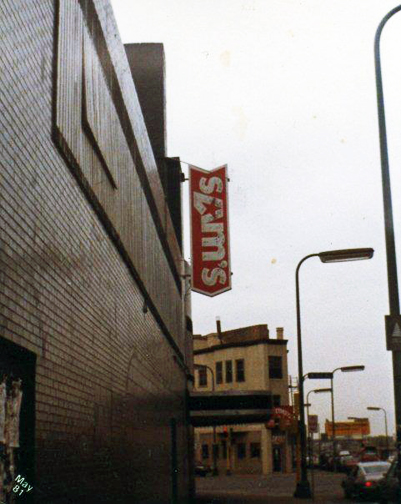
Photo copyright Steven Laboe
There was also a Drop Disco weekend, with only 274 people in attendance on the first Saturday. (30th). I haven’t found a date for this event.
Once the 7th Street Entry opened, determining which shows were in the Mainroom and which were in the Entry on various calendars is not necessarily easy. This is my best shot at Mainroom shows:
The first show at Sam’s was the return of the Ramones on May 11, 1980, possibly opened by Wilma and the Wilburs and the Overtones. (Jon Bream, Minneapolis Star, May 9, 1980)
April 16 and 18, 1980: Bo Diddley, accompanied by Curtiss A
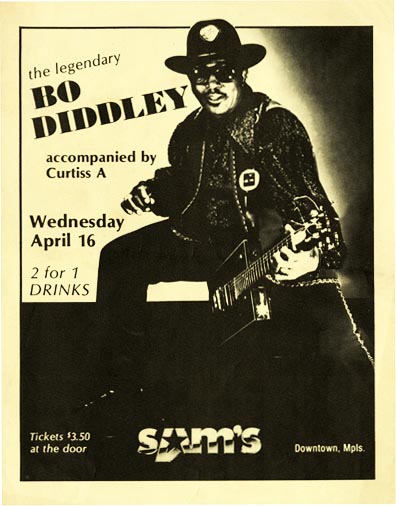
Flier image courtesy Chrissie Dunlap. From First Avenue: Minnesota’s Mainroom by Chris Riemenschneider, MNHS Press, 2017
April 23, 1980: Pretenders, with Curtiss A
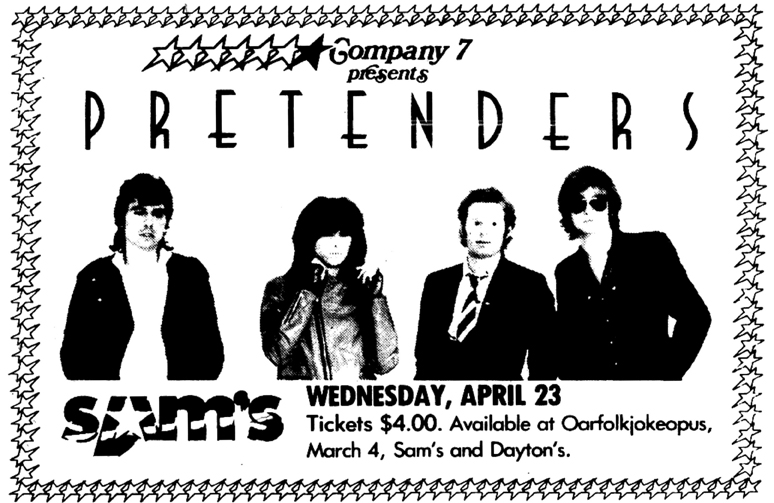
Sweet Potato, April, 1980
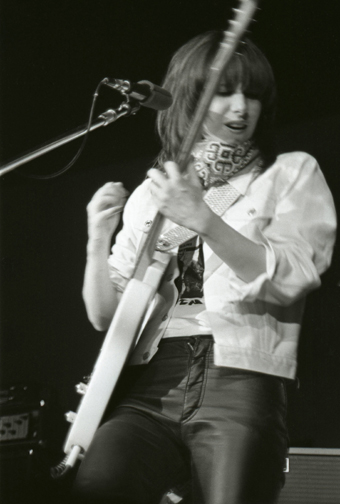
Photo courtesy Mike Reiter Images, From First Avenue: Minnesota’s Mainroom by Chris Riemenschneider, MNHS Press, 2017
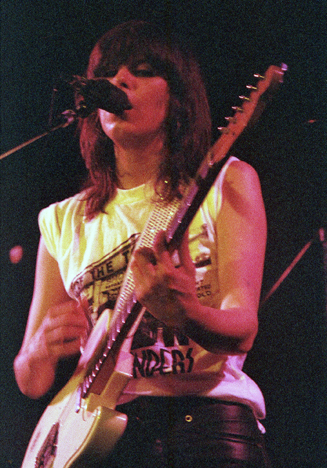
Photo courtesy Michael Reiter Images
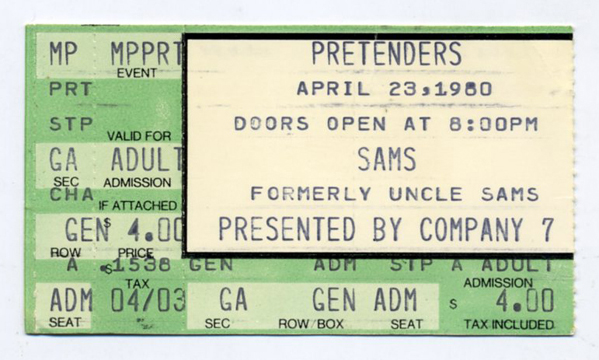
Photo courtesy Mike Reiter Images, From First Avenue: Minnesota’s Mainroom by Chris Riemenschneider, MNHS Press, 2017
[April 24, 1980: Joe Perry Project – CR] Unsure of venue; Sweet Potato says the 27th.
May 11, 1980: The Ramones, with Wilma and the Wilburs, and the Overtones
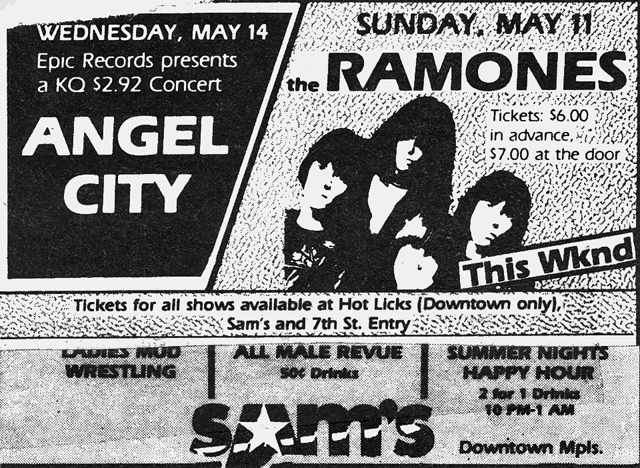
Ad courtesy Kevin Cole
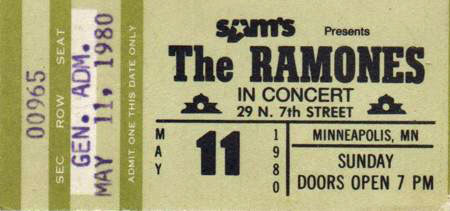
Ticket courtesy Jim Froelich
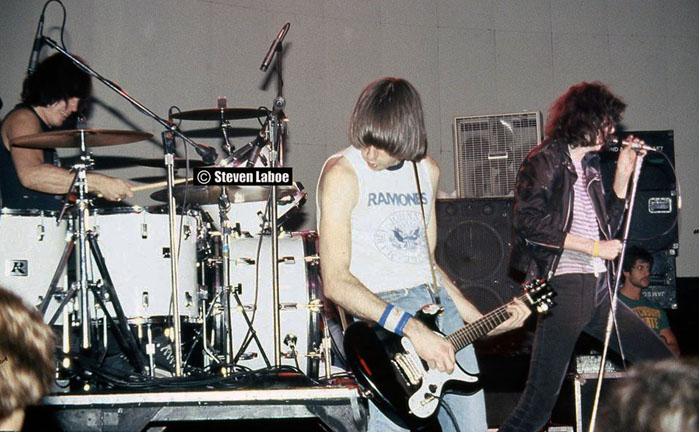
First Ramones show – copyright Steven Laboe
May 13, 1980 (Minneapolis Star): Disco was dying, and clubs were trying new things. Sam’s schedule of events:
- Mondays: Women mud wrestling
- Tuesdays: Male dancers
- Wednesdays: Rock ‘n’ Roll Revival
- Weekends: Two-for-one drinks/Disco
May 14, 1980: Angel City
May 25, 1980: The Romantics
May 28, 1980: Shakers
May 29, 1980: Tommy James
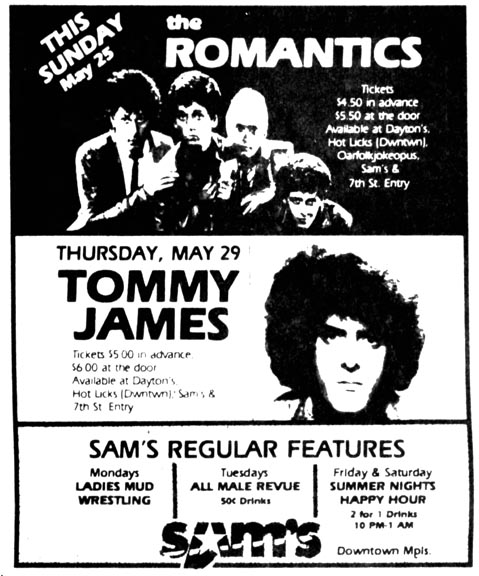
SWIMMING POOL AT A DISCO?
June, 1980: Mud wrestling was out, and Monday pool parties were in. Activities included competitive diving for pennies, water wrestling, bikini dips, and a men’s leg contest. Admission free to those wearing swimsuits. (Star, June 20, 1980) Apparently way more women were in the pool than men.
David Thomas remembers, “One night, one of the male strippers dove in and lost his G string. I was the life guard by the pool, summer splash party.”

Twin City Reader, June 11, 1980, courtesy Jeff Lonto
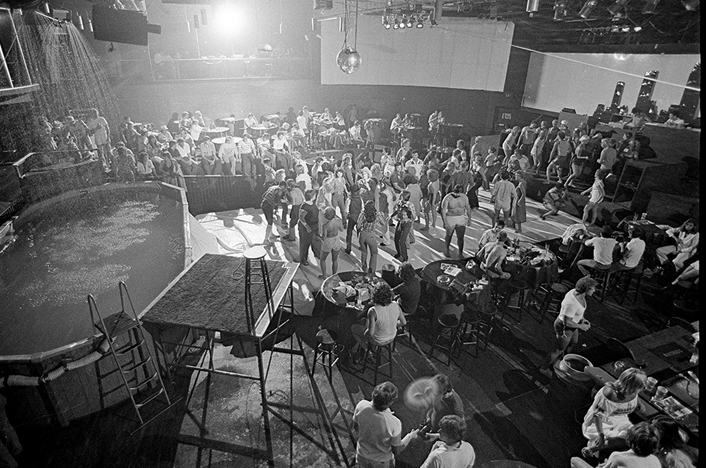
Photo courtesy Minnesota Historical Society via David Roth
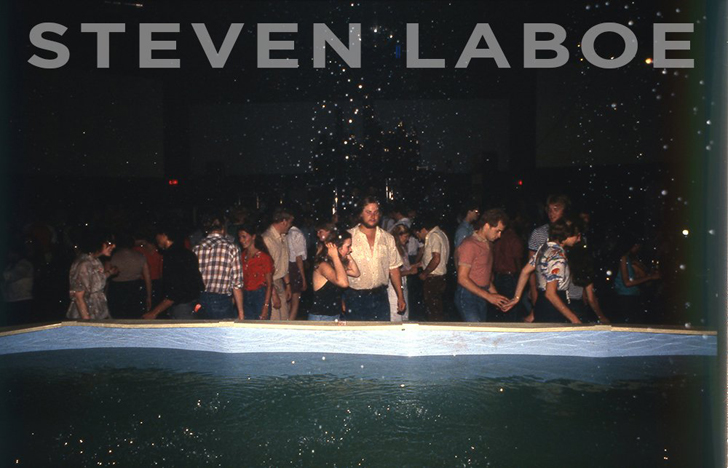
Photo copyright Steven Laboe
June 4, 1980: Trillion
SAM’S, A DANCETERIA
It was about the summer of 1980 that Steve McClellan attended the first New Music Seminar in New York City. The New Music Seminar website says that “In 1980, more than 200 people gathered at a New York City rehearsal studio to discuss and debate challenges in the music business.” Steve went to one club in particular called a “Danceteria,”at 252 West 37th Street, and was blown away at its size and features. He decided that he wanted to add the name to the Sam’s brand. (SM)
July 3, 1980: Russia, a “cute,” “contrived” band from Seattle that played “calculated rock,” according to Jon Bream.
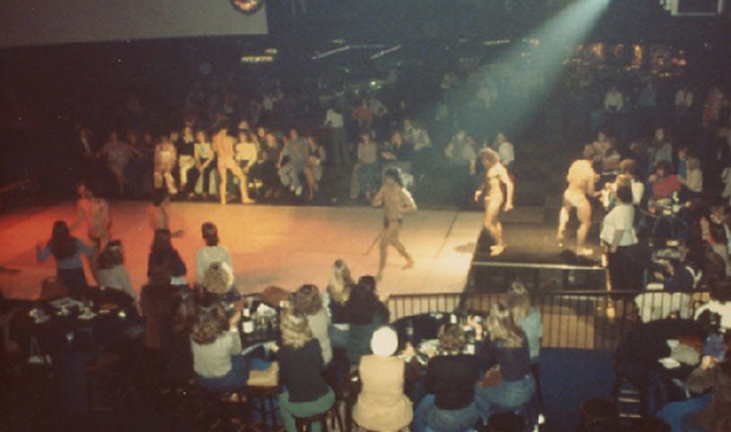
All Male Revue, Summer 1980. Photo copyright Steven Laboe
July 9, 1980 brought Bill Bruford, formerly with Yes. Also on the bill were local bands Dame and London. Steve Blexrud, a founding member of London, provided the ad below.
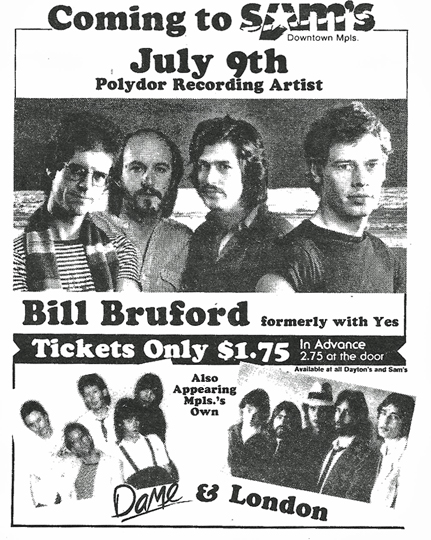
Courtesy Steve Blexrud via Neal Bond
The second coming of Gang War, with Johnny Thunders and Wayne Kramer, took place on July 30, 1980.
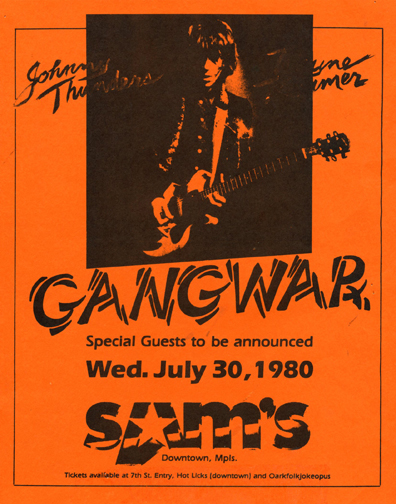
Photo courtesy Mike Reiter Images, From First Avenue: Minnesota’s Mainroom by Chris Riemenschneider, MNHS Press, 2017
October 16, 1980: John Cougar cancelled (CR)
In a review of rock venues, “the main dance floor at Sam’s is slowly changing from disco to pop-rock, while the side room, Seventh Street Entry, has declared itself new wave territory.” (Minneapolis Star, October 17, 1980)
November 5, 1980: Siouxsie and the Banshees, opened with the Solar Knights
November 9, 1980: The Hypsterz, with Wilma and the Wilburs and the Vendettas
November 13, 1980: Gamma, with Ronnie Montrose (CR)
November 16, 1980: L7-3, Video Show, Neglectors
November 30, 1980: Russ Morgan Orchestra Swing Dance
December 4, 1980: Jim Carroll – “New York poet-turned-rocker,” per Jon Bream
December 14, 1980: Angel City, from Australia
1981
January 22, 1981: Nona Hendryx and her band Zero Cool, opened by Things That Fall Down
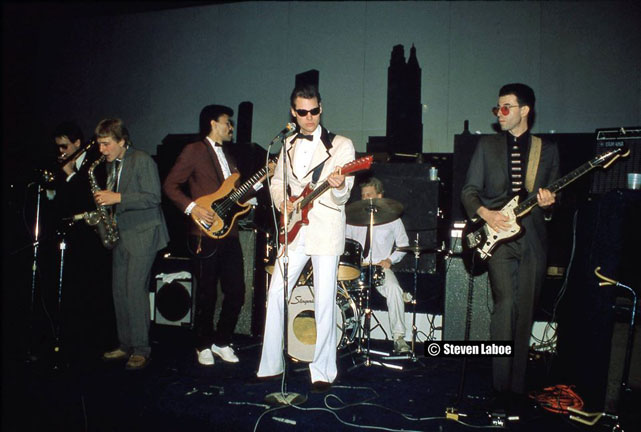
TTFD – photo copyright Steven Laboe
Don Engebretson on trombone; Roger ? on sax; Garrison White; Scott Brooks; Paul ? on drums; David Foley on bass.
January 28, 1981: The Romantics, with Fine Arts and the Phones
February 25, 1981: Lipps, Inc., featuring Steve Greenberg and fabulous lead singer Cynthia Johnson. This was the group’s first official appearance (after a private party). (Jon Bream, Minneapolis Star, February 20, 1981) The photo in the Star showed seven members of the group. Years later, when he was inducted into the Rock/Country Hall of Fame, Greenberg demonstrated how he and Johnson created the song by themselves in the studio.
March 2, 1981: Randy Meisner former bass player for the Eagles, opened by Jimmie Spheeris, “who probably still sings about the hippie ethic,” according to Jon Bream. (Minneapolis Star, February 27, 1981)
March 8, 1981: DNA [Opened by Husker Du]
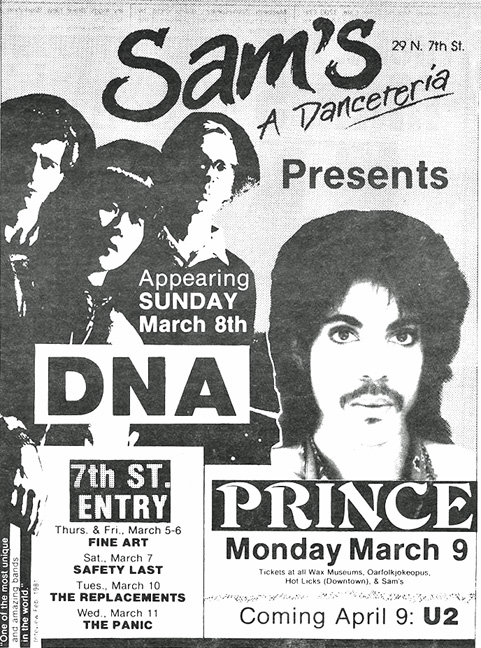
Courtesy Kevin Cole via Facebook
PRINCE’S DEBUT
March 9, 1981: Prince made his first appearance here, when it was still Sam’s. He had already appeared on “Saturday Night Live” and in Rolling Stone and Newsweek magazines. Curtiss A was the opening act.
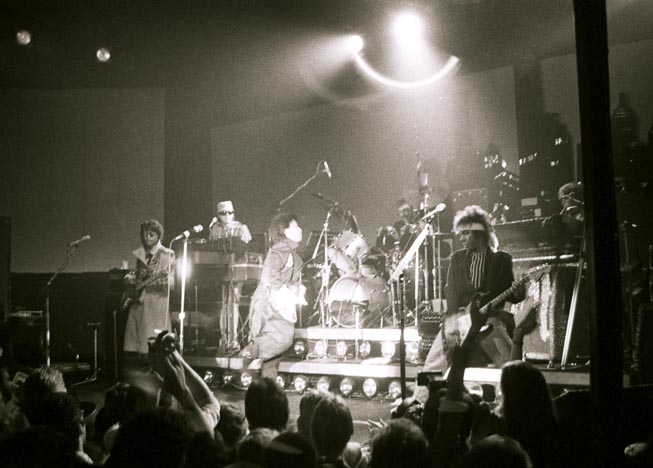
Photo of Prince courtesy Steve Madore. From First Avenue: Minnesota’s Mainroom by Chris Riemenschneider, MNHS Press, 2017
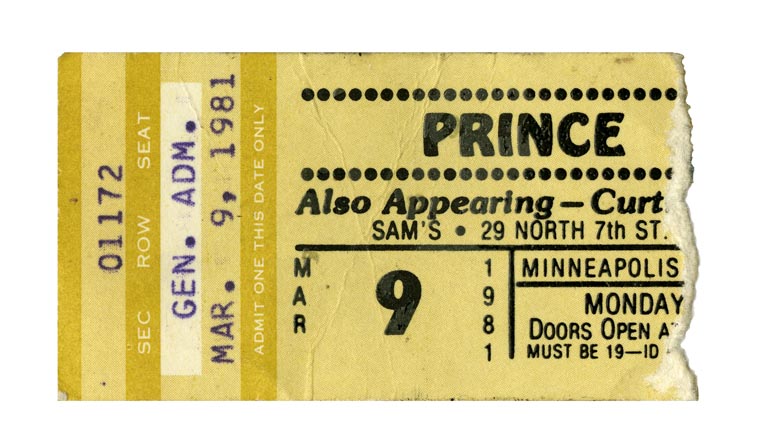
Image courtesy Don Hughes. From First Avenue: Minnesota’s Mainroom by Chris Riemenschneider, MNHS Press, 2017
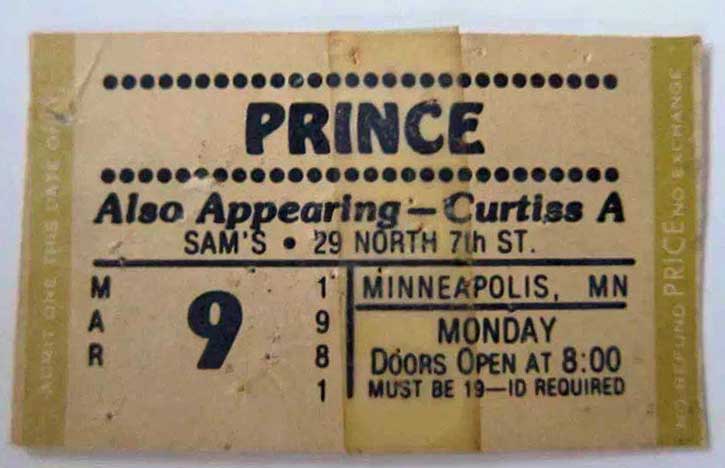
Another ticket from Colleen Foley
March 18 and 19, 1981: Brian Brain (Martin Atkins)
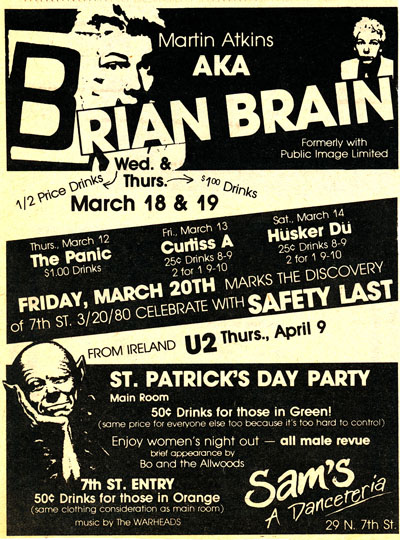
Image courtesy Kevin Cole. From First Avenue: Minnesota’s Mainroom by Chris Riemenschneider, MNHS Press, 2017
March 24, 1981: The ad below shows Secret Affair (From England) on the list of Mainroom shows.

Ad courtesy Jim Froehlich
GREAT PRETENDERS
Steve Dix tells us that The Great Pretenders contest began in April of 1981. Contestants with mocked-up instruments pantomimed songs in costume and the results were sometimes hilarious. “It was originally hosted by Louie Anderson. In the first few months it was totally dead, but picked up steam by the fall.”
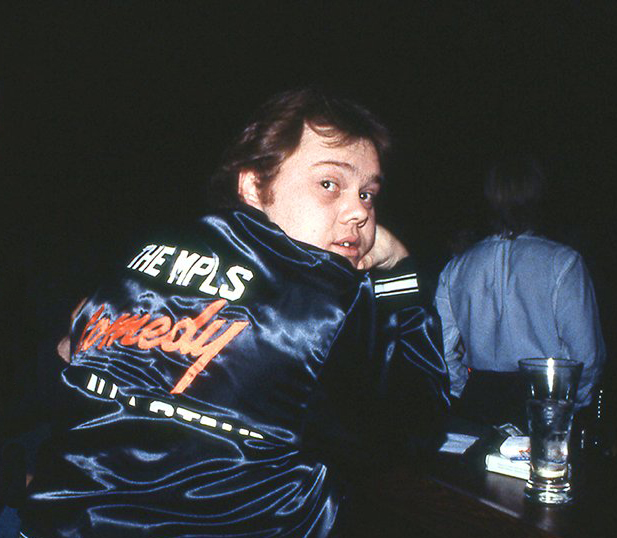
Louie Anderson, December 1981. Photo copyright Steven Laboe
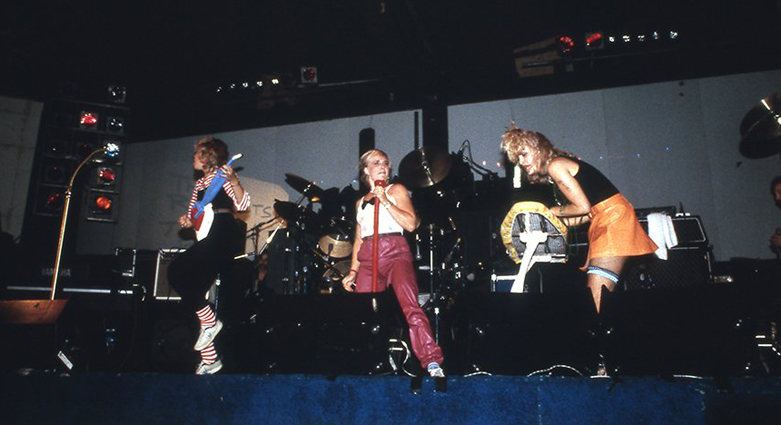
Contestants for the big lip-sync contest, “Great Pretenders.” Photo copyright Steven Laboe
THE YAMMIES
April 6, 1981: The Yammies, which turned into the first year of the Minnesota Music Awards, were held at Sam’s. They were sponsored by Sweet Potato magazine (thus their name), which in the next year turned into the City Pages.
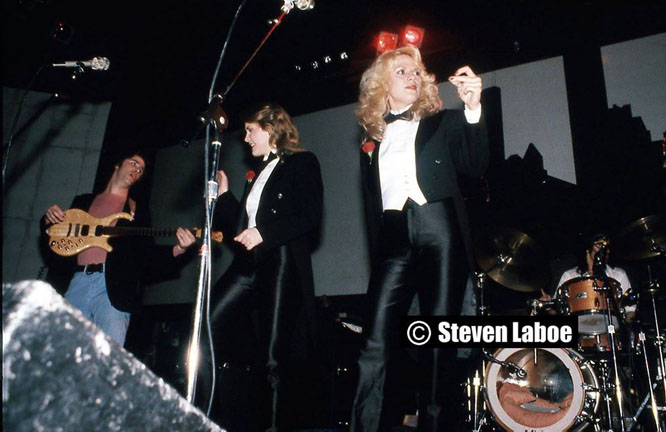
The Doug Maynard Band (Margaret Cox and Melanie Rosales) at the Yammies – photo copyright Steven Laboe
April 9, 1981: U2, described as “a clever, accessible Irish rock group featuring the grandiose vocals of Bono Vox” made its local debut. Opened by The Panic.
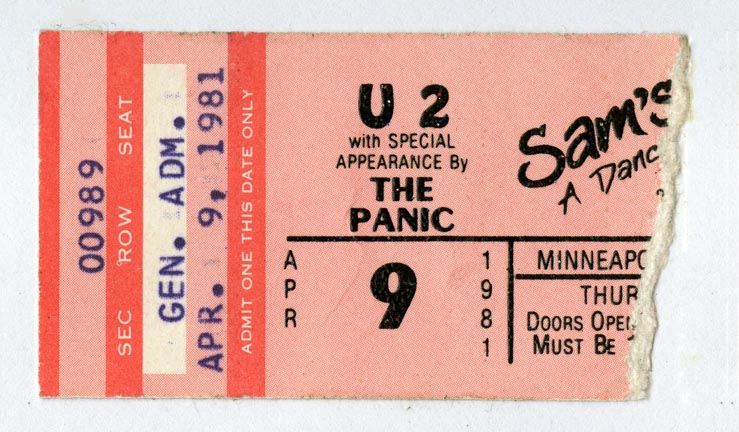
Image courtesy Don Hughes. From First Avenue: Minnesota’s Mainroom by Chris Riemenschneider, MNHS Press, 2017
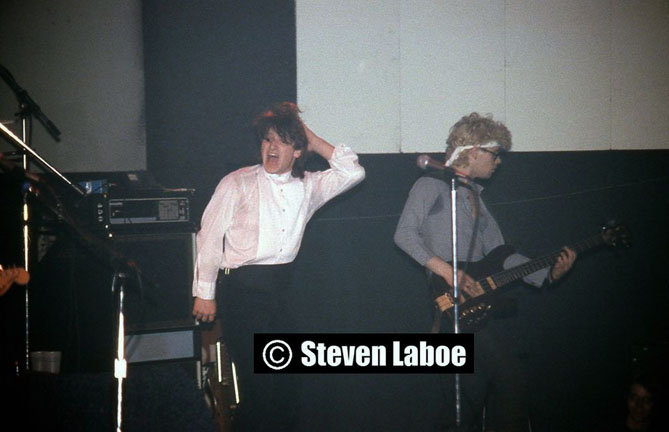
Photo from U2 Show – copyright Steven Laboe

The Panic – photo copyright Steven Laboe
April 13, 1981: Humble Pie. Steve McClellan remembers that the club lost money when only 500-700 people showed up.
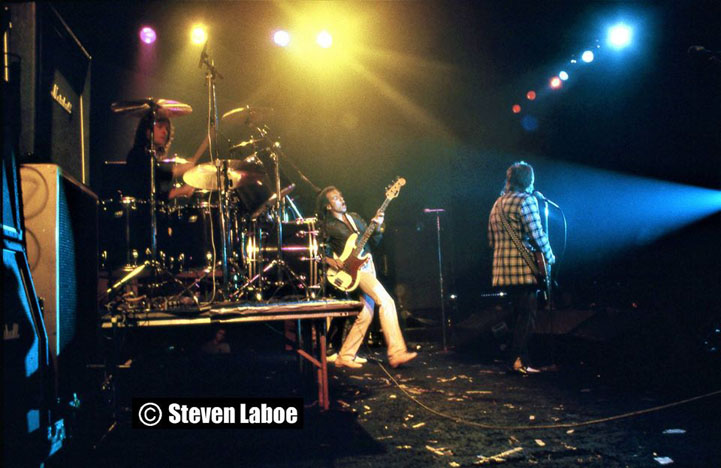
Humble Pie – photo copyright Steven Laboe
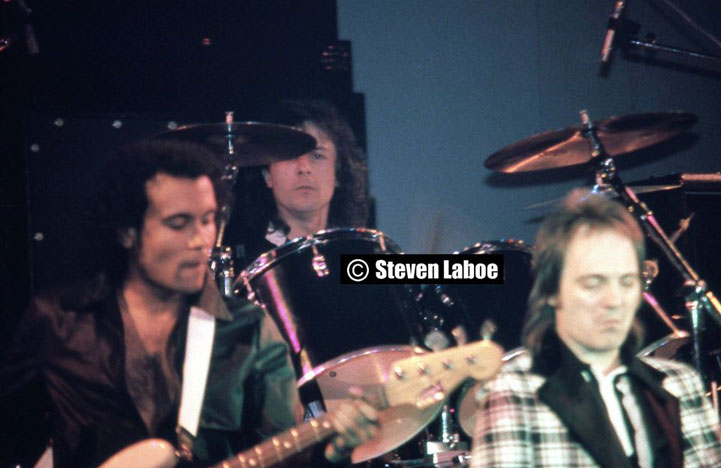
Humble Pie – photo copyright Steven Laboe
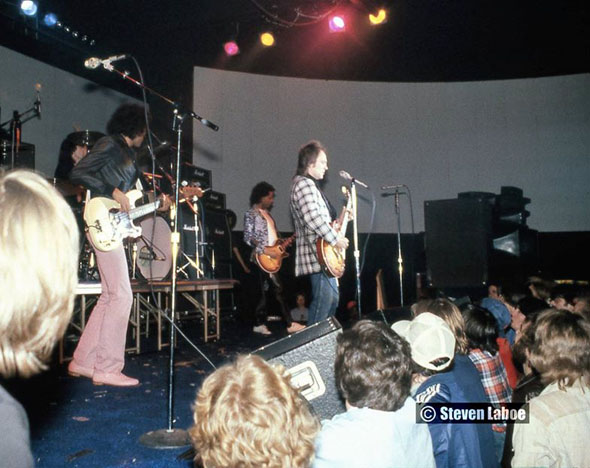
Humble Pie – photo copyright Steven Laboe
May 4, 1981: Raybeats
May 18, 1981: Robert Gordon with the Phones
May 20, 1981: A big triple bill featuring England’s The Stranglers, with the Hypsterz and the Warheads. Did the singer of the Warheads really throw White Castles at the audience?
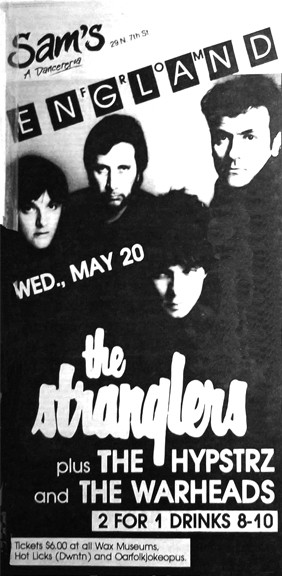
Image courtesy Mark Stang
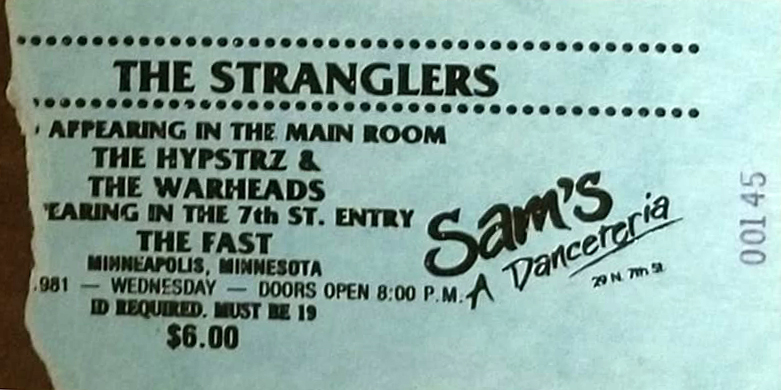
Image courtesy Mark Stang
June 1981 promotions included:
- Tuesdays: Ladies Night – All Male Revue
- Wednesdays: Free admission if dressed in a bathing suit
- Thursdays: Air guitar contests – $100 prize
June 8, 1981: Gary U.S. Bonds, opened by Fast Fontaine
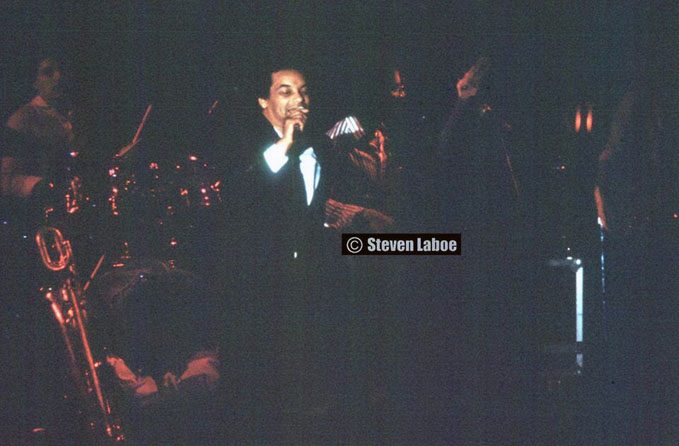
Gary U.S. Bonds – Photo copyright Steven Laboe
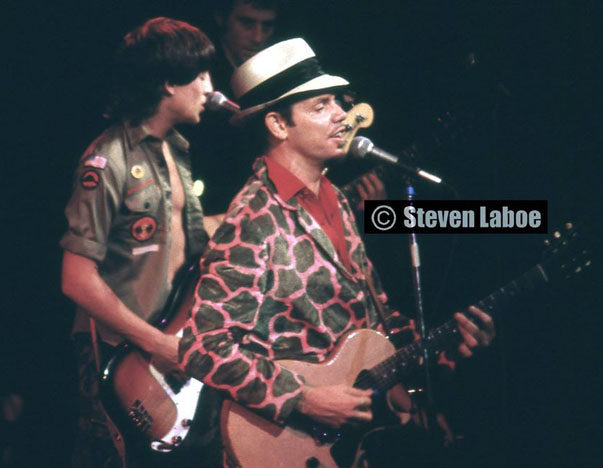
Fast Fontaine – photo copyright Steven Laboe
June 15, 1981: The Hypsterz’s final show before they became the Mighty Mofos. Husker Du, Bizarre, Warheads
June 22, 1981: Debut of Johnny Rey and the Reaction. Also on the bill were the Crash Street Kids, The Innocents, and MC Doug Podell from KQRS. This performance is on YouTube!
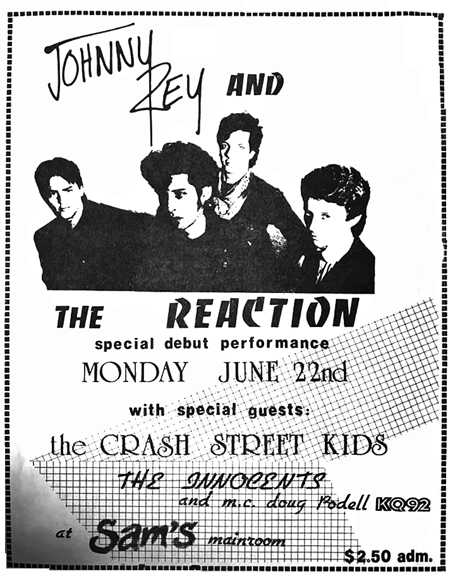
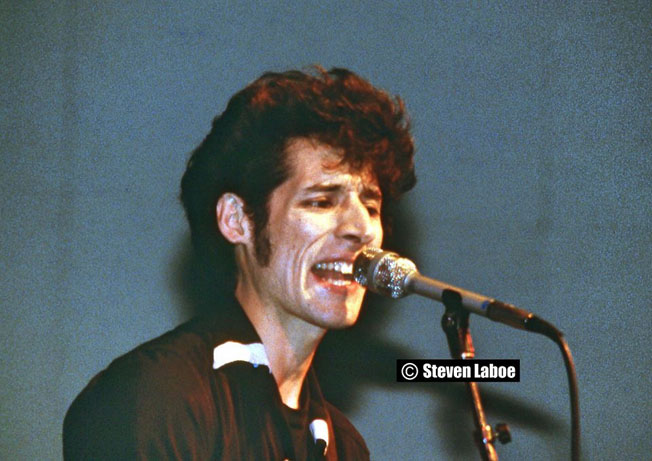
Johnny Rey – photo copyright Steven Laboe
June 25, 1981: Billy Squier, opened by Peer Group
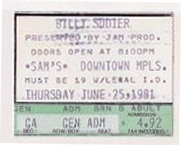
Ticket courtesy Kimberly Davis
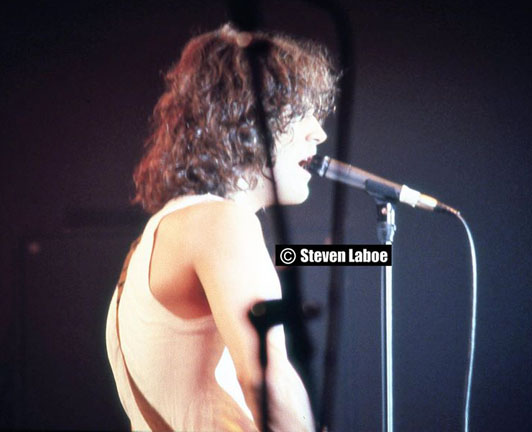
Billy Squier – photo copyright Steven Laboe
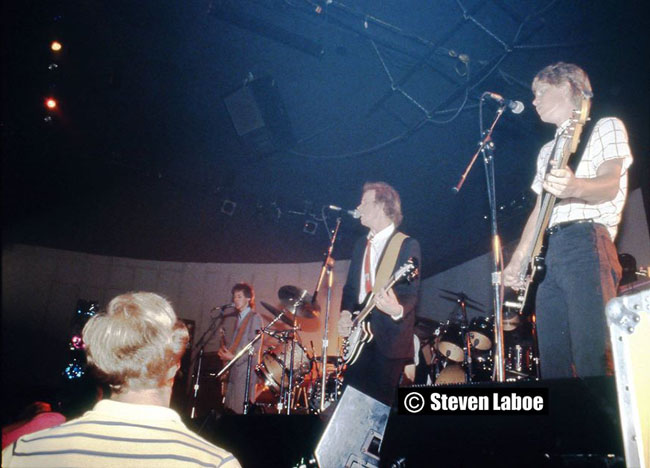
Peer Group – photo copyright Steven Laboe
Jim Rheingans, guitar, center stage; Tom Kelly, bass, on right.
July 1, 1981: Aquadance; Cameo with Ben Day Dots
July 2, 1981: Great Pretenders; Cameo with Peer Group
July 3, 1981: Cameo with the Innocents
July 4, 1981: Cameo with the Rems
July 6, 1981: Greg Kihn Band with DDD
July 7, 1981: Ladies Night; Cameo with The Odd
July 8, 1981: Aquadance; Cameo with Enterprize
July 9, 1981: Great Pretenders
July 10, 1981: Cameo with Peer Group
July 11, 1981: Cameo with the Eyeliners
July 13, 1981: The Suburbs
July 14, 1981: Ladies Night; Cameo with Phantasy
July 15, 1981: Aquadance; Cameo with Stagger Lee
July 16, 1981: Great Pretenders; Cameo with Phantasy
July 17, 1981: Cameo with Wilma and the Wilburs
July 18, 1981: Cameo with Mark Throne
July 19, 1981: Psychedelic Furs
July 21, 1981: Ladies Night; Cameo with Mark Throne
July 22, 1981: Aquadance; Cameo with the Units
July 23, 1981: Squeeze, with Peer Group and Agent Orange
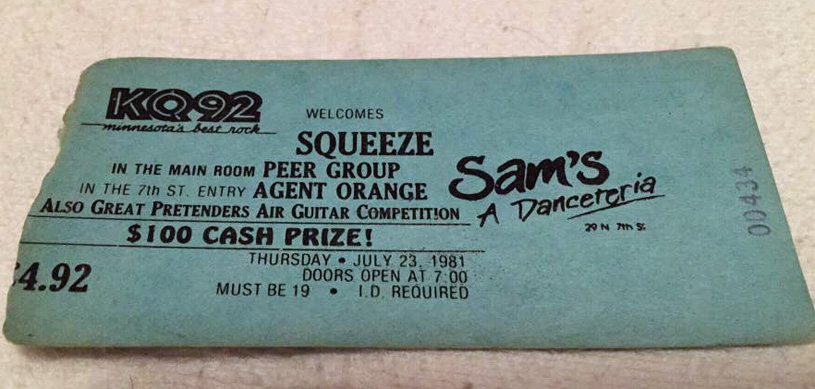
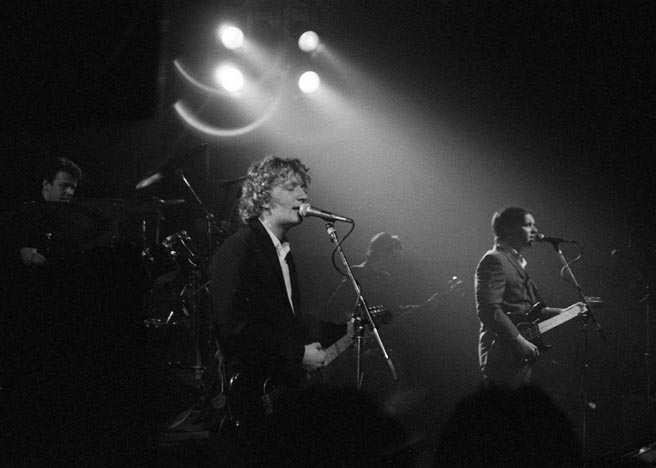
Photo of Squeeze courtesy Steve Madore. From First Avenue: Minnesota’s Mainroom by Chris Riemenschneider, MNHS Press, 2017
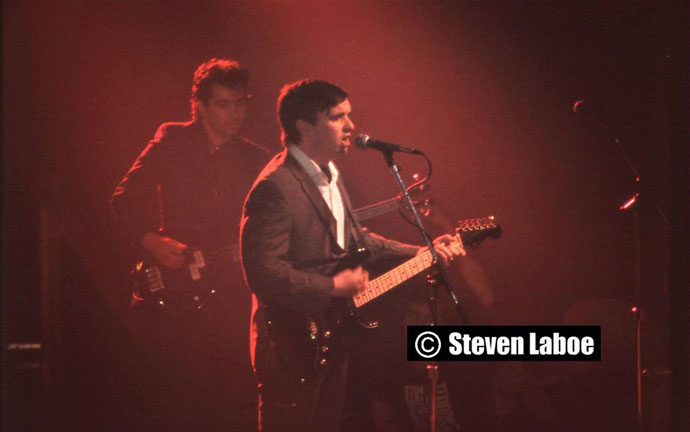
Photo of Squeeze copyright Steven Laboe. Chris Difford on guitar and Harry Kakoulli, bass
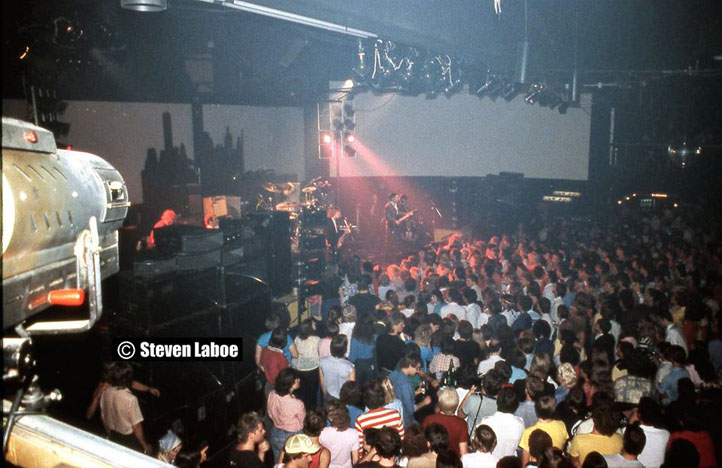
Squeeze show photo copyright Steven Laboe
July 24, 1981: Cameo with Fine Art
July 25, 1981: Cameo with Wilma and the Wilburs
July 28, 1981: Ladies Night; Cameo with Fine Art
July 29, 1981: Aquadance; Cameo with the Hypsterz
July 30, 1981: Great Pretenders; Cameo with Agent Orange
July 31, 1981: Cameo with Agent Orange
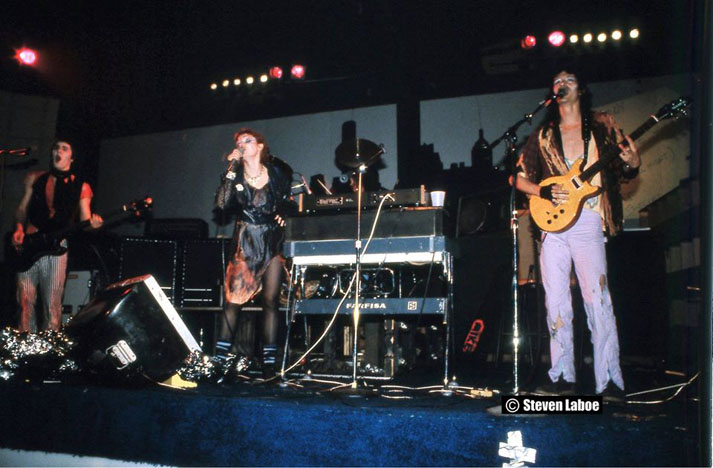
Agent Orange photo copyright Steven Laboe
August 26, 1981: Lamont Cranston, with Johnny Rey and the Reaction and L 7-3. Part of second anniversary celebration of Sweet Potato magazine.
September 7, 1981: Fine Art, Situation, Skamets
September 14, 1981: Mixed Metaphor, Tatters Fall Fashion Show
September 21, 1981: Hypsters, Necessaries, Dads
September 28, 1981: This was the third and final appearance of the Ramones before the club became First Avenue.
We’re not entirely sure, but the consensus seems to be that these photos are all of the 1981 show:
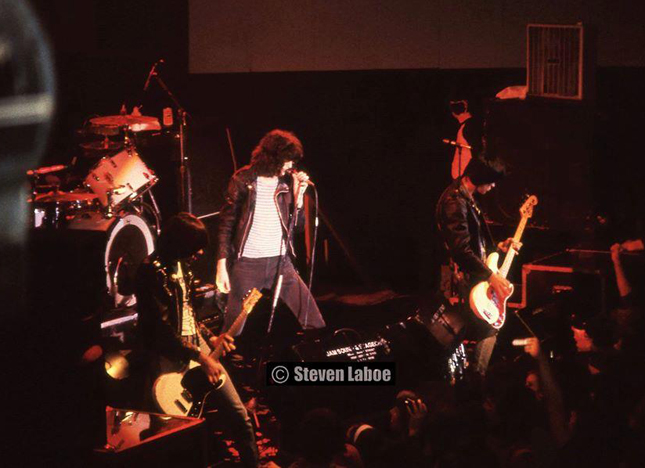
Photo copyright Steven Laboe
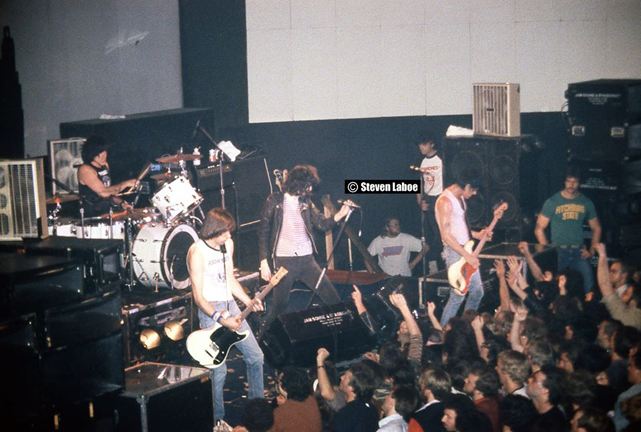
Photo copyright Steven Laboe
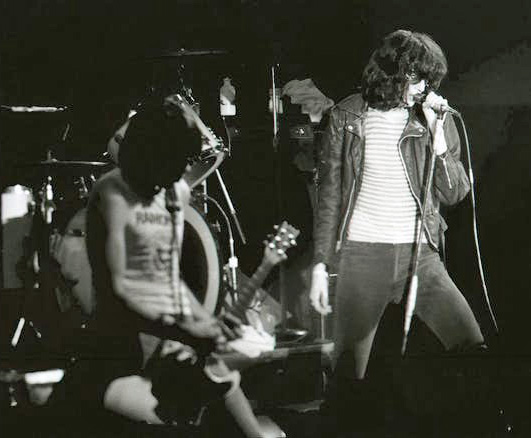
Courtesy Michael Reiter
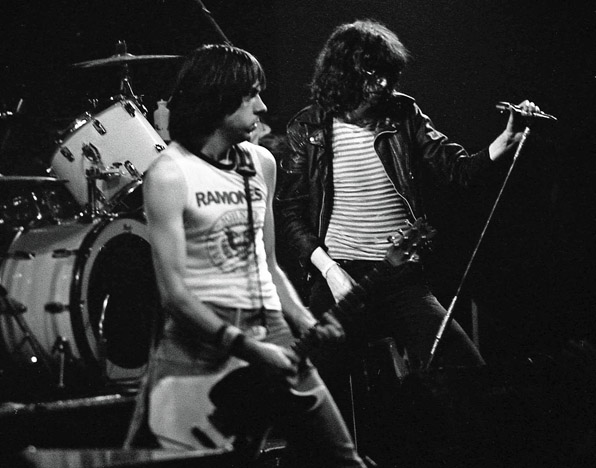
Courtesy Michael Reiter
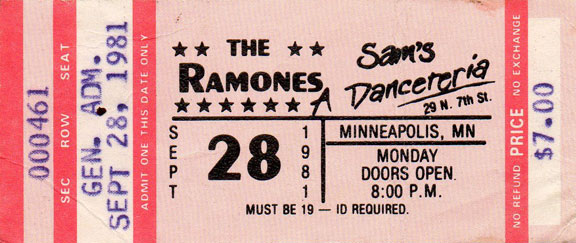
Ticket courtesy David Nelson
October 5, 1981: Safety Last was scheduled for the Mainroom. In addition to or instead of that group, the audience got a second performance from Prince. Steven Laboe caught this shot:
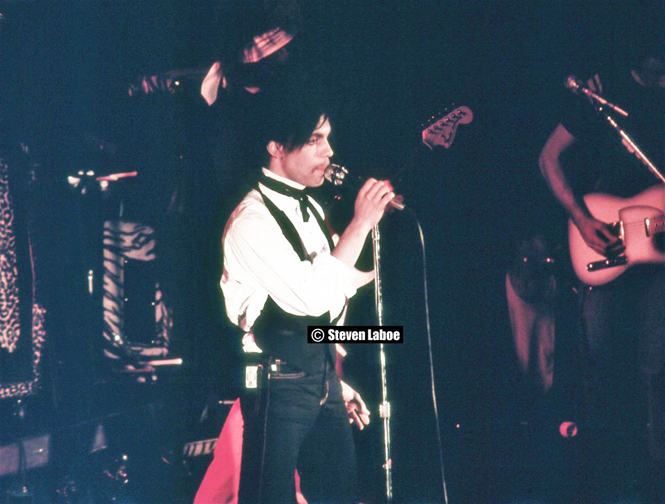
October 5, 1981. Photo copyright Steven Laboe.
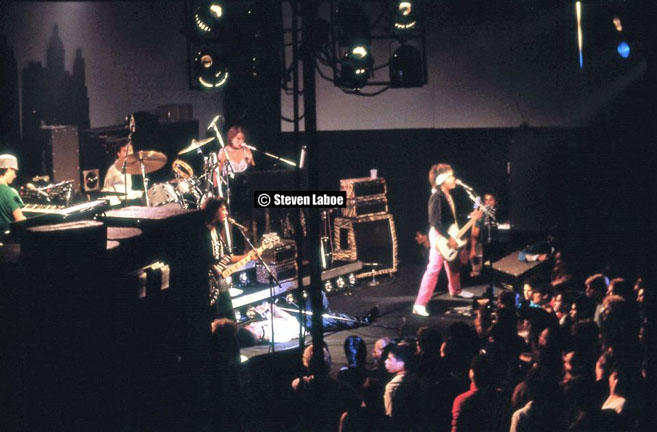
Dez Dickerson with the Revolution – photo copyright Steven Laboe
And from that or another time, below is a photo of Safety Last: Sprague Hollander, Tim Mauseth, Jim Tollefsrud, and Rusty Jones
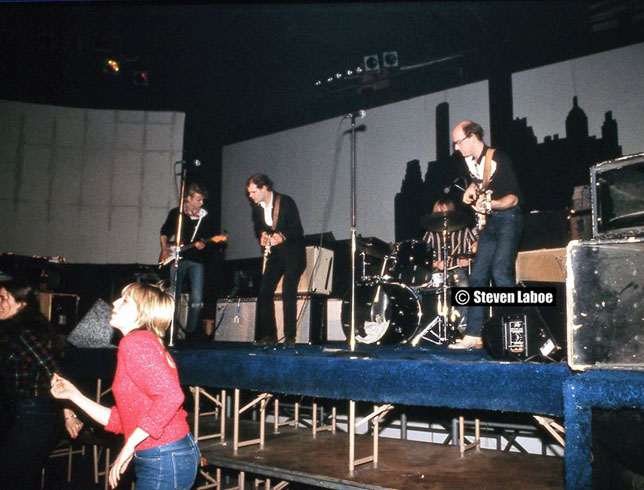
Safety Last – photo copyright Steven Laboe
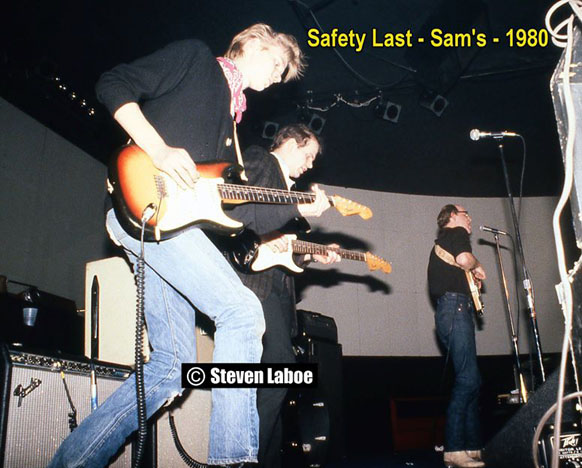
Safety Last photo copyright Steven Laboe
October 7, 1981: The Time. This was the first performance of the Time since they changed their name from Flyte Time. My college friend Tom Lund was in Flyte Time! The Time had a hit called “Get it Up,” and were all 19 and 20 years old. The show opened with Sue Ann Carwell, with her new band.
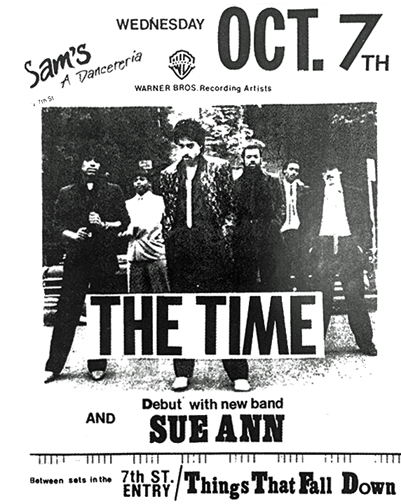
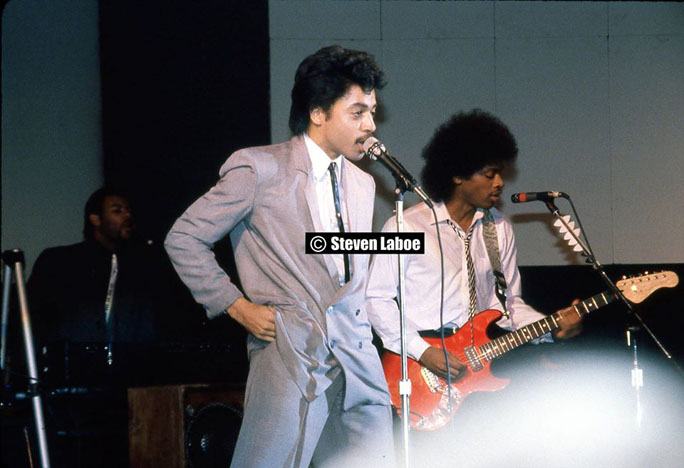
Morris Day and the Time – photo copyright Steven Laboe
October 14, 1981: Dance Cabaret – Benefit for the Minnesota Dance Theatre
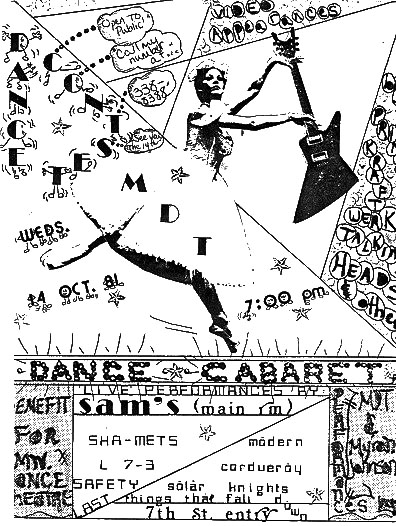
Courtesy Ron Clark
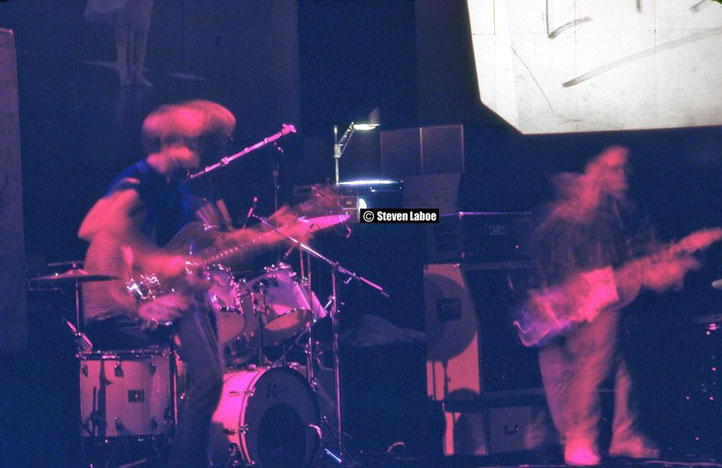
L 7-3 photo copyright Steven Laboe
October 19, 1981: Raybeats, Suburbs, Skamets
November 5, 1981: Siouxsie and the Banshees
November 17, 1981: The Panther Burns
[November 26, 1981: R.E.M. was originally booked for the Entry but the Mainroom band cancelled, so Steve moved them to the Mainroom. Only 88 people were in the audience. It was Thanksgiving night. CR]
November 30, 1981: Russ Morgan Orchestra directed by Jack Morgan. Sponsored by WLOL
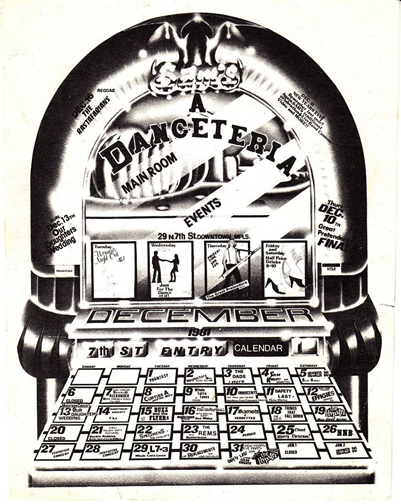
December 13, 1981: Our Daughter’s Wedding
December 15, 1981: Buzz and the Flyers
December 16, 1981: Rastafarians
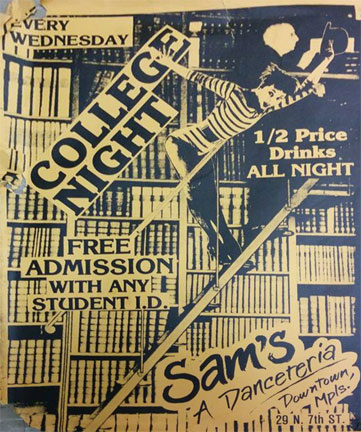
Poster courtesy John Kass
On New Year’s Eve 1981, Manager Steve McClellan and his staff renamed the club First Avenue. Steve Laboe captured the very last moments of Sam’s.
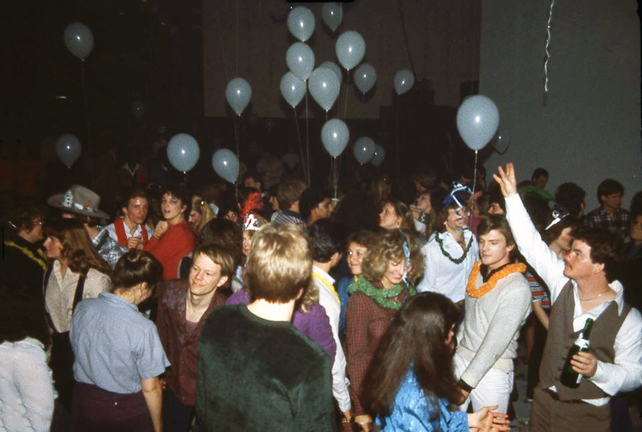
Photo copyright Steven Laboe
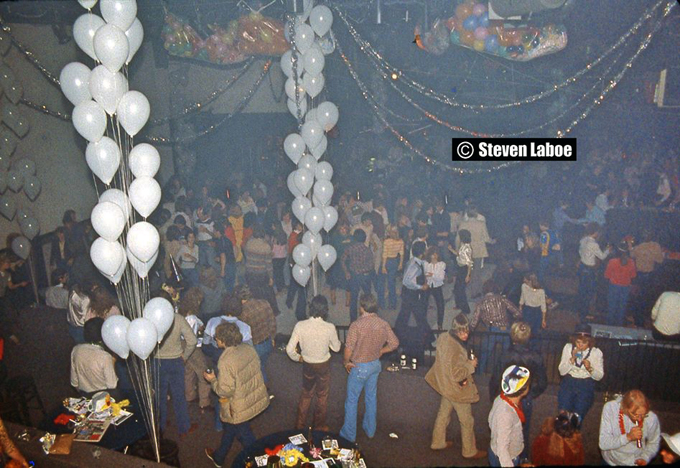
Photo copyright Steven Laboe
THE END OF SAM’S
Let’s give the last word to Dix Steele:
I began working at the club in March of 1975 when it was Uncle Sam’s, part of a string of national discotheques. I stayed until December of 1983 when it had become First Avenue, and continued in a freelance graphic artist capacity until December of 1993.
By far and away, the period of the most fun were the Sam’s years. Nobody knew what they were doing, no one knew what direction we were headed in, lots of times we didn’t know if the payroll would be met.
But was it ever exciting! We got to see bands and listen to music no one else had heard in these parts. It was total chaos at times, and I wouldn’t have traded anything in my life for the amount of fun we all had then.
From female mud wrestling, to building a swimming pool on the dance floor, to being kicked in the chest by Johnny Ramone, this was probably the best time of my life. It was like the wild west at times, lots of fights, lots of parties, and lots of mayhem.
I was happy to have been there.
FIRST AVENUE: 1982 –
The history of First Avenue has been covered elsewhere, and is way past my usual 1974 cutoff date, so I won’t be listing any shows. There’s a list of First Avenue’s live performers Here. It is not a complete list, and work is being done to fill in the blanks.
I will note some events in the early days of First Avenue.
1983
The club was shut down from November 26 to December 20, 1983, for the filming Prince’s 1984 film Purple Rain. The song “Purple Rain” itself was recorded at First Avenue on August 3, 1983, during a benefit concert for the Minnesota Dance Theater, which had been providing dance lessons to the cast. Fun fact: the cast used a warehouse in St. Louis Park as a rehearsal space – it has since been demolished.
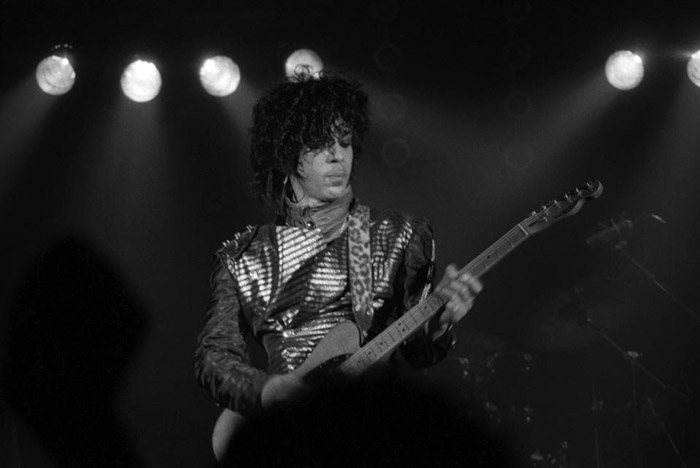
Photo from Getty Images
1984
The film “Purple Rain” opened on June 27, 1984, here in the Twin Cities and the venue became nationally famous as the central setting. Tourists began to annoy the management, but Allan says that the Prince connection really saved the club. (AF)
In an attempt to improve the “quality” of the clientele at First Avenue, the club asked the city if it could institute a policy of admitting only patrons age 21 and above, but was denied permission on the basis that it was discriminatory. (CRM)
1986
On September 1, 1986, the drinking age went back from 19 to 21 after passage of a Federal law in 1984 that mandated that states would face 10 percent reductions in federal highway funds unless they raised their age to 21. Allan said that this was extremely bad for business, and he got so he didn’t want to come in when attendance was low. (AF)
1988
Allan moved to California to focus on his fine-art publishing business in San Rafael and an art gallery in Sausalito, visiting First Avenue only once a year. (Inc.com)
1996
STEVE McCLELLAN WINS THE CONNIE HECHTER AWARD
At the Minnesota Music Awards of 1996, held on July 11, appropriately enough at First Avenue, Steve was honored with the Connie Hechter Award, which recognized the contributions of a non-musician. Jon Bream wrote:
In his 23 years at First Avenue, McClellan probably has worked with at least 40 of the acts that earned [Minnesota Music Awards] in 48 categories this year. Working 12-hour days and weekends, he oversees booking and marketing. He received the most prolonged applause of the long night.
Jack Meyers, First Avenue’s CFO, introduced McClellan and saluted him for his “integrity, commitment and stubbornness” and for “putting Minnesota and First Avenue on the map as the place where music comes first.”
… “In April 1993, the Twin Cities Reader published a cover story calling him “the crabbiest man in Minneapolis.” More important, McClellan, 46, has been a tireless promoter of all kinds of music from worldbeat to disco to alternative-rock.
The Connie Hechter Award was chosen by the Board of Directors of the Minnesota Music Academy, which administers the Minnesota Music Awards. The other MMA winners were chosen by the 264 members of the Academy.
2002
A Hard Rock Café opened on the north side of Seventh Street (Block E) on September 12, 2002. This music venue was looked at with trepidation as a possible rival to First Avenue. Problems at Block E caused mass exodus, and the Hard Rock closed on September 30, 2011.
2004
McCLELLAN AND MEYERS ARE LET GO
On June 22, 2004, Management team Steve McClellan and Jack Meyers were fired by letter from California by Allan Fingerhut. “Fired” may not be the exactly correct term, McClellan clarified; he and Meyers, as 2M, had a Management Agreement with the Committee that Allan decided to terminate. (SM) Steve got the news during the Patti Smith concert that night, packed his things, and left.
The news of Steve McClellan’s departure ripped through the Twin Cities music scene. (MPR)
Chris Osgood:
Steve leaving First Avenue is really no worse than if the Art Institute burned down, or if the Walker blew up. McClellan took a non-profit approach in an intensely for-profit cutthroat world. As a result, he introduced audiences to music and bands they might not normally come across…. He was able to recognize and nurture talent early on, and give it a garden to grow in. (MPR)
MPR’s Chris Roberts tried to explain Fingerhut’s motives:
Most every night at First Avenue, a customer shift change occurs at around 9:30 or 10:00. That’s when the rock, world music, or hip hop concert ends and the club becomes a cavernous, dingy discotheque. Tonight, as danceable rock music booms out through the speakers, the dance floor is pretty much empty. It’ll be Chris Olson’s job to fill it regularly. Olson, former Director of Operations for the club is now the new General Manager. [CR wrote that Olson had been an employee for 10 years.]
Allan Fingerhut says the club has to broaden its audience. There’s talk of establishing air guitar, lip synch, and Karaoke style competitions, as well as playing much more danceable recorded music. [At the rumor that the firings were a precursor to selling the club,] Fingerhut scoffed at the idea. “It’s like selling my, well, it’s my second born baby… What am I going to do? If I can’t be creative with First Avenue I’m going to die…. Steve has done a great job. I have absolutely nothing to complain about with Steve. It’s a non-profit business, First Avenue. But it has to be self-reliant for another 35 years, to last. I don’t care if I make money or not. I just want it to continue.”
Fingerhut freely admits his position on First Avenue’s future may be wrong. He says he would have preferred to stay behind the scenes, but the fact the club was sinking forced him to come out of the shadows and make a decision.
THE COMMITTEE DECLARES BANKRUPTCY
At 1:30 pm on November 2, 2004, The Committee, Inc. filed for Chapter 7 bankruptcy and First Avenue closed. The full story is told in Section IV of this page. First Avenue would reopen 17 days later under new ownership. The bankruptcy put the Committee out of business, rendering its stock worthless.
ALLAN’S REACTION TO LOSING FIRST AVENUE
Allan was quoted as saying that the club “was never intended to make money.” He said that he had to declare bankruptcy because of two lawsuits against him. He said he paid $570,000 in startup costs and $120,000 in 2004. Finance director Jack Meyers disputed that figure and said that Fingerhut hadn’t put any money into the club since 1979. (Minneapolis Star and Tribune, November 13, 2004)
New York Times:
“I got beat out of my bar fair and square, but I don’t want to be attacked anymore,” [Allan] said. “How can I be the bad guy in all of this? I lost $800,000 and half my hearing keeping this place going as long as I did.”
At that point Allan owned three art galleries that generated $5 million in sales the year before. “Still, nothing can make up for the First Avenue debacle. Losing that club was like losing a child,” he says. (Inc.com)
III. BEFORE THE MUSIC
Now that we’ve heard all the music, let’s go back to the beginning – the very beginning – to find out what was on this hallowed piece of land before our beloved First Avenue. Yes, we know it was a Greyhound Station, but Steve McClellan clued me to the fact that there was actually a grade school at 7th and First before the walls started to throb.
JEFFERSON SCHOOL: 1877 to 1916
Information for this section came from the Minneapolis Tribune and Journal, 1870 – 1914, and the Minneapolis Permit database made available by the Hennepin County Library.
Jefferson Elementary School was first located at Tenth Street and Hennepin Ave., built in about 1870. When it burned down in December 1876 (no injuries during an orderly escape), the school board sold this prime piece of real estate to the Methodist Church for $10,000 and bought a similar sized property at Seventh Street No. and First Ave. No. for $8,250. L.S. Buffington designed the new Jefferson School, and Smith and French built the building for under their bid of $16,400. The building had eight rooms, 25′ x 30′ each. The school opened on September 10, 1877, a week late and unfinished, but functional.
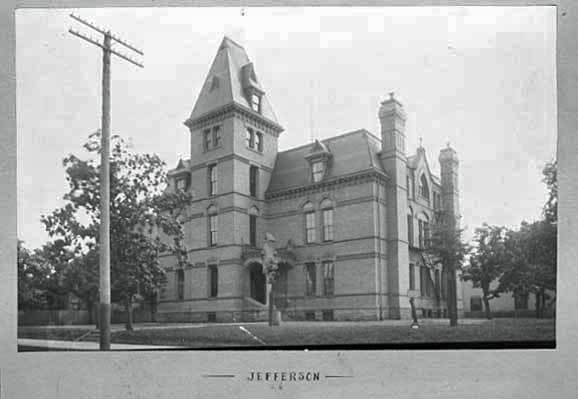
1800 photo courtesy Minnesota Historical Society
In December 1903 it began to occur to people that this grade school in the middle of a rowdy downtown was perhaps not in the best location. Nearby “vicious resorts” included Ida Coates’s House of Ill Repute (now the State Theater site) and a profusion of gambling joints on Seventh Street No. and Glenwood Ave. (then called Western Ave.) In addition, there were fewer children in the area, and in 1906 the school board was looking to sell.
And then there was the time in 1909 when Jack “The Hugger” struck, trying to embrace the girls as the came out of school. This phenomenon was happening all over the country, Jack based on Jack the Ripper. When he was in danger of being mobbed at Jefferson, he pulled a gun and escaped. Sounds like something that might have happened 100 years later!
The Last Dance for Jefferson School was in June 1910, and students gathered to honor their school and President Jefferson one last time. Meanwhile the school board was in no particular hurry to sell the property, knowing that its value was skyrocketing. Plus the city council kept dilly-dallying about how wide they wanted to expand Seventh Street, eventually widening it from 60 ft. to 80 ft.
The building was finally sold to Stacy Brothers & Merrill Co. on July 1, 1914, for $90,000. At about the same time, North High had a fire and Jefferson was leased by the school board as a storehouse for $1,200 per months for eight months. The permit to demolish the building was finally approved on April 26, 1916, at a cost of $1,000.
As far as I can tell, Jack the Hugger was never captured.
UNION BUS DEPOT: 1916 to 1935
The next building on the corner was a large (165 ft. x 150 ft.) brick building that housed four stores and a large (110 ft. x 125 ft.) public garage. Ads indicate that the building was known as the Union Bus Depot as early as 1922. At this point it was using the address 29 No. 7th Street.
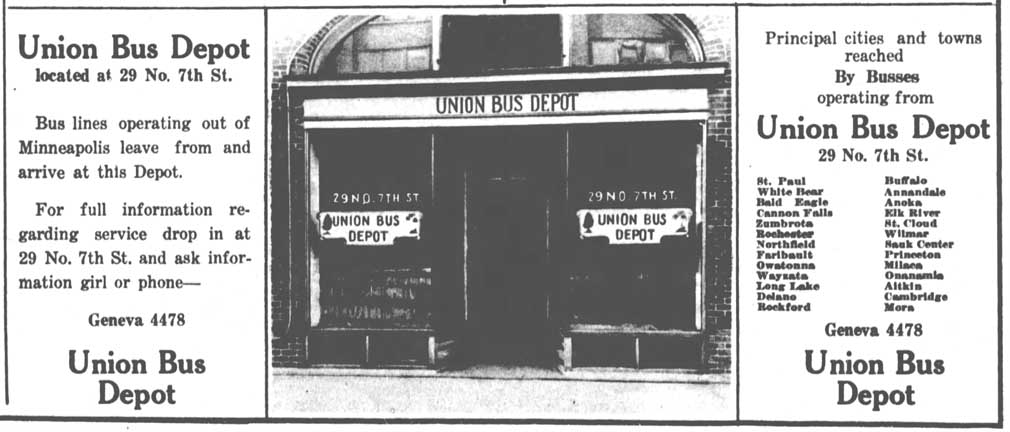
Minneapolis Tribune, April 30, 1922
In 1924 there were major alterations made so that buses would no longer have to load and unload on Seventh Street. A garage and two stores were altered to triple the size of the waiting room and provide space for 18 buses to load and unload off the street. The Minneapolis Daily Star reported it as a new station, “erected on the site of the old station,” although it was actually an alteration, according to the permit card.
There were still stores in the building, including a pipe shop and a soda fountain. In 1932 the permit card mentioned a theater. On August 5, 1935, there was a permit to spend $450 to repair the stores after a fire. There is no wrecking permit for this building on the permit card. And as you can guess, there are a lot of permits for signs!
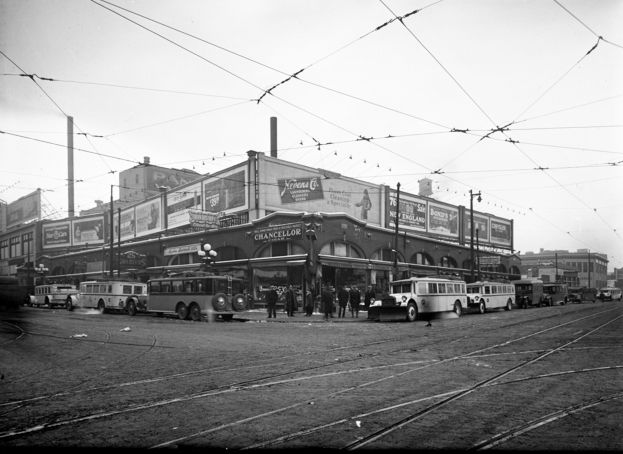
1925 Photo Courtesy Minnesota Historical Society
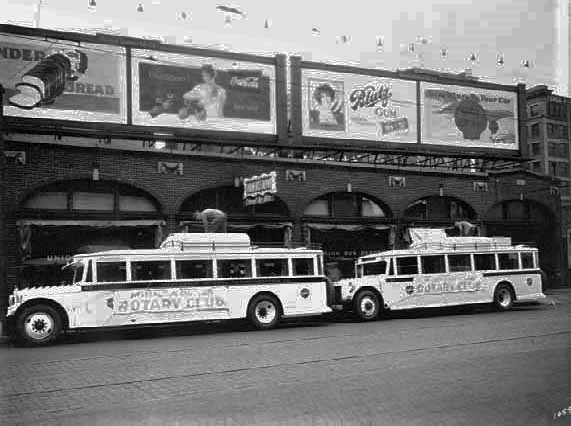
Jefferson Lines Fageol buses, 1930. Photo courtesy Minnesota Historical Society
NORTHLAND GREYHOUND STATION: 1937 to 1967
Information for this section came from the Minneapolis Star and Tribune.
CONSTRUCTION
The present building was designed by architects Oscar Lang and Arnold Raugland. It was built on the site of the old building, and it was built in a hurry. The James Leck Company began construction on the massive building in August 1936, and it was dedicated on February 26, 1937. While the new station was under construction, temporary quarters were established on a vacant lot south of the site on First Ave. No. The daily bus load was 109: 67 Greyhound, 32 Twin City Motor, and 10 Jefferson.
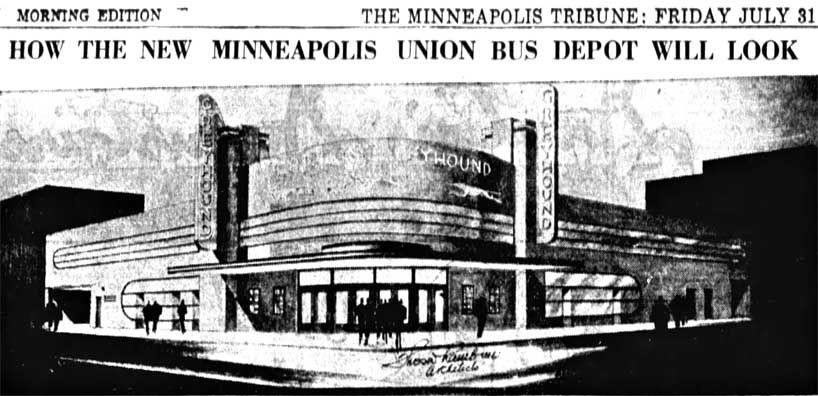
Ownership:
Stacy Bros. & Merrill Co. continued to own the land and the new building, and they leased it to Northland Greyhound. Jefferson Transportation and Twin City Motor Bus Co. were tenants.
Exterior:
The lot was 165 ft. on Seventh Street and 209 ft. on First Ave. Construction was of blue glazed brick with white trim on the north and west sides: the colors of the Greyhound line. The Minneapolis Tribune described it as “one of the finest of its kind and a model of convenience and scientific design.” Long, continuous windows ran the full length of the building. A marquee was studded with 300 lights.
The first floor:
- Huge, chromium chandeliers diffuse light throughout the main waiting room, aided by smaller fixtures placed at vantage points along the ceiling of the lounge.
- Five doors conform to the curved contour of the structure.
- The waiting room was 68 ft. wide by 158 ft. long and 28 ft. high. (Another report said 70 ft. by 115 ft. and 8,050 sq. ft. in total.) It is and elliptical in shape, with solid walnut benches.
- The walls are tinted in old rose.
- The ticket office has five windows.
- Barber shop (beauty shop didn’t happen)
- Cigar and news stand, with entrances from the waiting room and the street
- A battery of public telephones
- A commodious baggage room
THE FLOOR
The floors were of green and yellow terrazzo. While they were covered up for most of their tenure at first, they are uncovered today and those original floors are still in service. Robb Henry found the photo below that shows the waiting room floor in 1966.
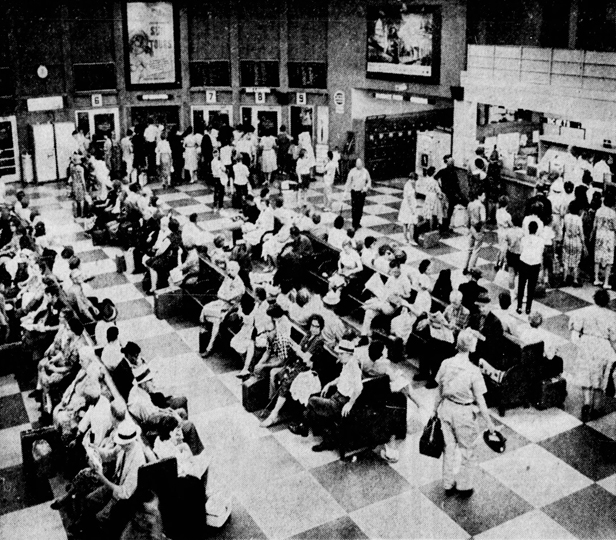
Minneapolis Tribune, July 9, 1966
THE POST HOUSE RESTAURANT
This was described as a “scientifically equipped” restaurant. The space went through several uses before its evolution into the 7th Street Entry.
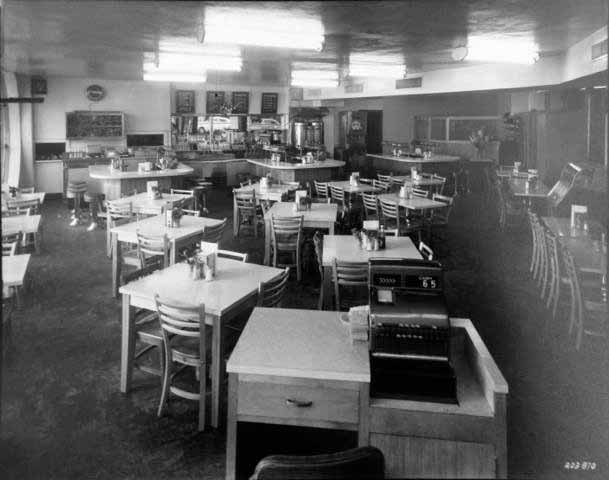
Greyhound Restaurant, 1961. Photo courtesy Minnesota Historical Society
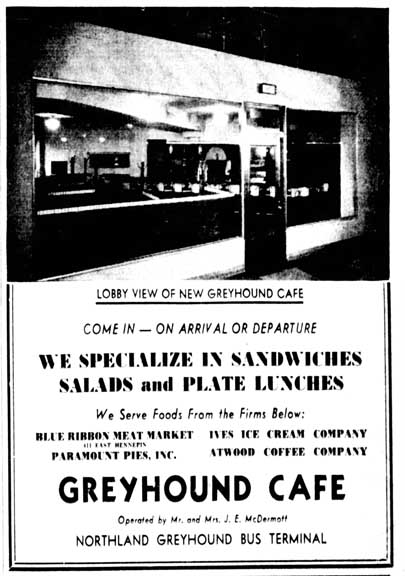
Minneapolis Tribune, February 26, 1937
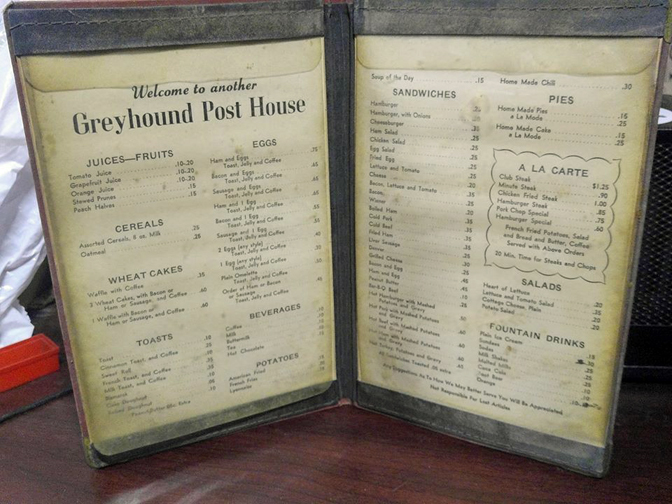
Menu found in the walls of the Uncle Sam’s checkroom! Image courtesy John Kass
The Mezzanine:
- Two winding staircases
- Lounges overlooking the waiting room, “furnished with divans and settees, which combine comfort and a brilliance of clean, gleaming chrome with yellow and green upholstery.’
- Restrooms on the north side, with black and blue tile and five feet of wainscoting. Walls and ceilings are painted in ‘old rose.” Tiled shower rooms are also available.
- Showers, with floors covered in black and red asphalt for safety.
- Terminal Offices, including the switchboard and first aid office.
Nine doorways lead to the loading platform. The garage could handle the loading of 11 buses at once, with arrivals from Seventh Street and departures from First Avenue. The entire concourse could handle 25 buses.
And, a special note was made of the public address system, providing, “plain, audible announcements of bus departures and arrivals and for the paging of passengers.”
THE DEDICATION
Although the opening missed its goal of January 1, 1937, the station was dedicated and formally open to the public in a ceremony on February 26, 1937. The celebration included orchestra music by the Gopher Melody Men, and singing and instrumental specialty acts by the Three Tones. Uniformed hostesses distributed souvenirs.
WCCO Radio broadcast a half-hour dedication ceremony at 9:30 pm, where W.J. Kay, Vice President of Northland Greyhound, presented the terminal to the City of Minneapolis, with Mayor Thomas E. Latimer accepting.
Next came the christening of the first super coach officially to leave the terminal. The particular coach would make a regular run to Hibbing, the birthplace of Greyhound Lines. Joyce Kerr, U of M co-ed and recent winner of the Big Ten Beauty Queen Contest, did the christening honors.
The occasion was the subject of a special section of the Tribune, beginning with the full-page graphic below:
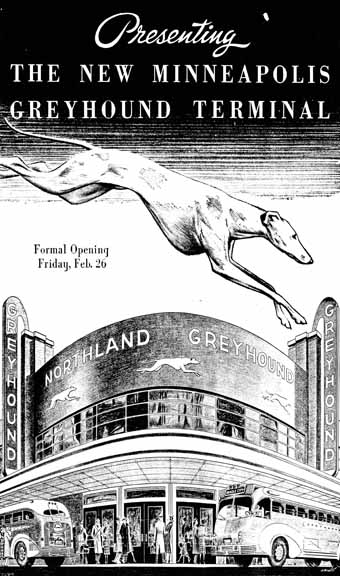
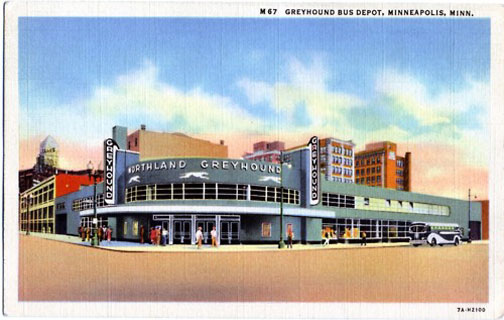
1937 Postcard courtesy Hennepin County Library Special Collections
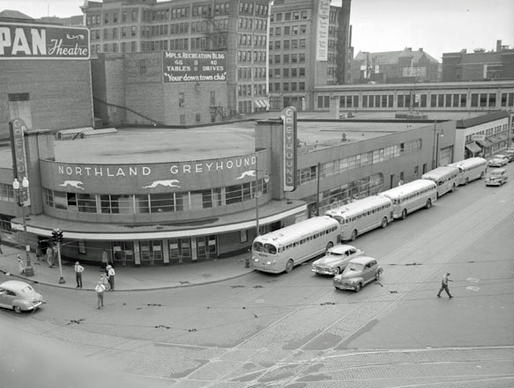
Photo courtesy Minnesota Historical Society
From this 1952 photo below, it is apparent that the infrastructure of the building never really changed much:
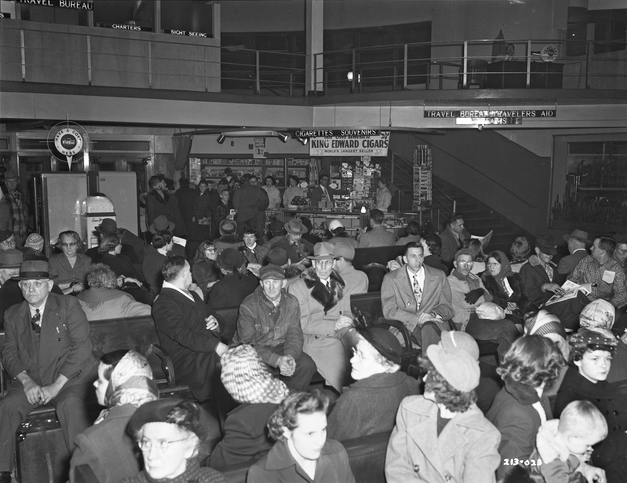
December 5, 1952, photo courtesy Minnesota Historical Society
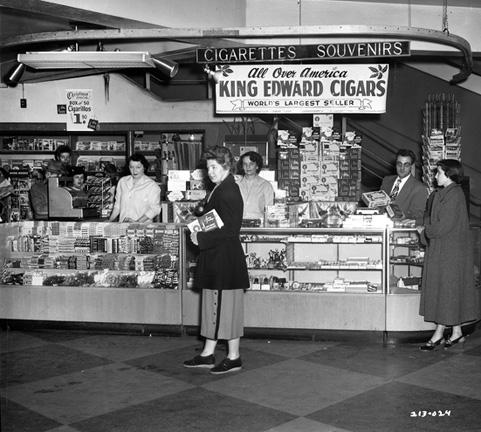
Candy counter, December 5, 1952. Photo courtesy Minnesota Historical Society
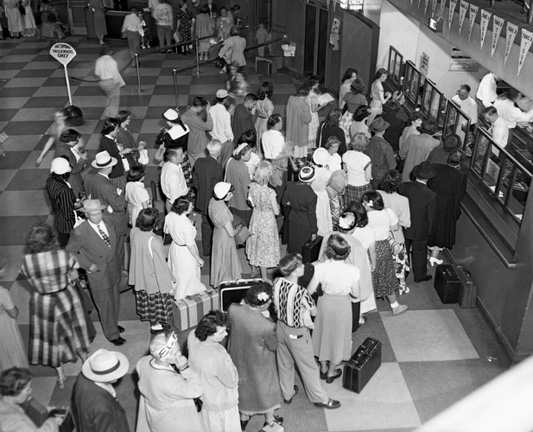
Ticket booth, July 1, 1950. Photo courtesy Minnesota Historical Society
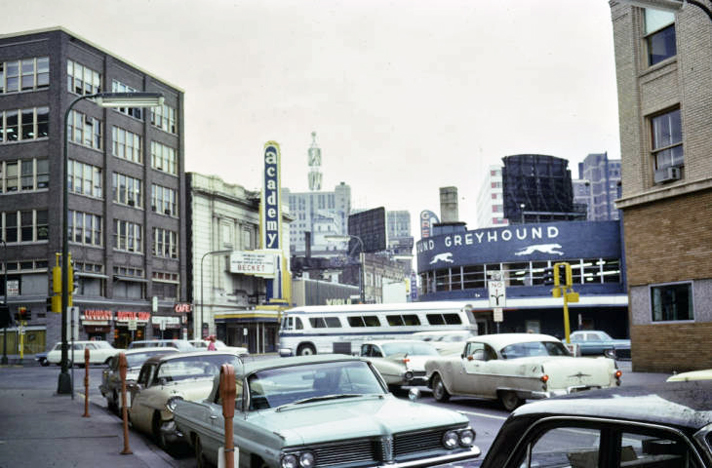
Glenwood Ave., October 1965 – Bus and Station. Photo courtesy Hennepin County Library
GREYHOUND GONE
On June 22, 1967, the Minneapolis Star reported that Ted Mann had purchased the Northland Greyhound Station and that Greyhound would be building a new station on the block bounded by Hawthorne, 9th Street, Currie, and 10th Street. The new Greyhound site was a vacated Holiday Oldsmobile dealership. It eventually cost $2 million to renovate, and according to Peter Altman of the Star, in his review of November 29, 1968, it was butt ugly. (“New Depot Has Clean Look But No Style”)
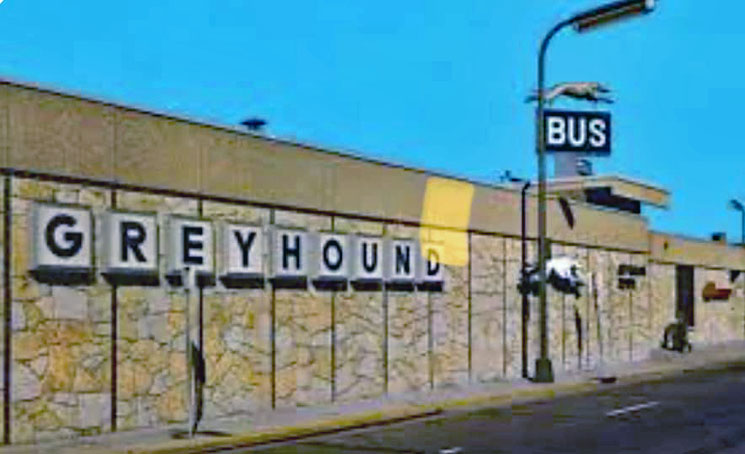
The Depot’s replacement Building: “Butt Ugly.” Photo courtesy Tom Barton
That Greyhound station was eventually replaced by the current Hawthorne Transportation Center, built by the City of Minneapolis in 2000 on the same site as the last one. It includes a 900-car parking lot, was next to the 7th Street Municipal Parking Garage, provide connections to Metro Transit (which the last one didn’t), had food and play areas, and was open to ticket holders only. The architect was Gene Nelson and was presumably not ugly.
So much for buses.
IV. HISTORY OF THE COMMITTEE, INC.
And finally we get to the history of the organization that owned this business from 1970 to 2004. To some it will seem as exciting as paint drying, and some of it is admittedly mundane and technical. But some of it is bizarre, and there are plenty of surprises. The story is complex, confusing, and messy, but I have not made any of this up!
I have decided to summarize the story to make it at least readable – if anyone wishes to see the entire tome or any of my original sources, feel free to let me know. I have interpreted the assorted documents to the best of my ability, but I caution that I am not an attorney (although I did take contracts before I quit law school in 1982…). A reminder that my sources are listed on a separate page, hopefully for your convenience.
I am also not trained in handwriting analysis, and can only report on whose signatures appear on the various documents. Some of these signatures have been suspected of being forgeries – I have no way of knowing one way or another. The vast majority of the documents I’ve depended on have come from governmental agencies, and I have tried to report on whether or not various signatures have been notarized.
As with every other Twin Cities music venue on this website, my goal is to discover and present the facts. I have no other agenda and have no point of view. This is my work and no one else’s – typos and all. I have indulged in a few personal opinions at the end.
If anyone has any objections, additions, suggestions, rebuttals, or corrections to anything I’ve written, I invite them to contact me and let me know. I wish to include all points view and allow everyone to be heard. Thank you.
THE BUILDING
The old Greyhound bus depot was purchased by brothers Ted and Marvin Mann in June 1967. Ted Mann wanted the building because it was next to his Mann Theater at 710 Hennepin Ave. The acquisition gave him the entire east (well, northeast) side of the block. The Mann Theater is now the Pantages. (Minneapolis Star, June 22, 1967)
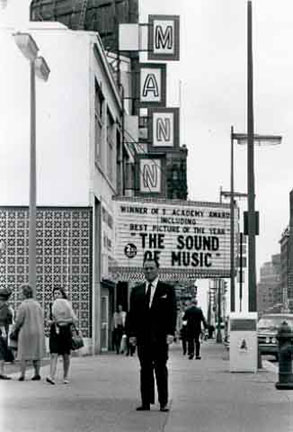
Tedd Mann, 1966. Photo courtesy Minnesota Historical Society
Mann had no immediate plans for the old Greyhound building. And although it is unclear when Greyhound actually moved out, its new Depot was opened in September in 1968, and it appears that Mann did nothing to the old one while it was in his ownership.
SOMEONE GETS AN IDEA
Whose idea it was to turn the abandoned bus station into a nightclub is a little hazy. These are the stories I’ve read and heard.
DANNY STEVENS
The following section comes from interviews with Danny Stevens in 2020.
Danny remembers getting the idea to use the old Greyhound depot as a music venue after visiting the Sunset Strip in L.A. in 1967 and venues like the Fillmore West in particular. In fact, he had met Bill Graham and wanted to name the new Minneapolis venue the Fillmore Midwest. This meeting was set up by Timothy D. Kehr.
Danny called and met with Ted Mann in 1968. He knew Ted from when he was an usher at Mann’s Suburban World Theater in the ‘50s. He asked Ted that, if he had a chance to get a liquor license, would Ted be willing to lease the building to him? Ted did not want to sell it, and Danny did not have the capital or the confidence that the idea would work to buy it. Danny put $2,500 to $3,000 of his own money down to hold the building and went out looking for investors. Rent was set at $2,500 to $3,000 per month, and would not start until construction was done.
When Danny was looking for financing to start up the Depot, he first thought of his friend Mrs. Heffelfinger. Elizabeth E. Heffelfinger was the wife of Frank Peavey Heffelfinger, heir to the Pillsbury grain fortune. He had met her through Lynn Lawyer, who Danny met in 1964 and who became publicist for Danny’s Reasons in 1965. Through Lynn he had an entre into Wayzata and Minnetonka Society. Danny’s Reasons performed at many functions – private parties, parties for teenage kids of society folks, etc., and had many connections with wealthy patrons. This is how he met Mrs. Hefffelfinger. Mrs. Heffelfinger was excited about the idea and participated in meetings with Ted and Marvin Mann and her friend Jack Dow. She guaranteed the rent for two years. Unfortunately, Mrs. Heffelfinger became ill and asked Danny if he could try to find another financial backer.
ALLAN FINGERHUT
When Allan got out of the Army he considered using some of the money his father had given him to open a nightclub. (CR)
SKIP GOUCHER
Charles Bradley “Skip” Goucher was either a footnote to this story or the founding father of the Depot. Allan told me that Skip, an acquaintance, brought the building to his attention. Allan liked it for its lack of support beams and unimpeded sight lines. (AF) This is substantiated by Goucher’s son, who said that his dad “always claimed credit for dreaming up the club.” (CR) Although Goucher’s name is not mentioned in early press reports about the Depot, he is mentioned as one of Allan’s “sidemen” in an article in Connie’s Insider dated April 11, 1970.
There are some who think that Goucher’s role has been underplayed. One of them is John Fineberg, who was a disk jockey on KRSI and KQ in the early 1970s. Here’s what John has to say:
The truth is that the founders of The Depot were my brother, Tom Fineberg, and his friend/roommate/business partner, Skip Goucher. Tom (who now goes by the name Thomas) were in the concert booking business. While driving around downtown Minneapolis, in search of a venue to hold concerts, they came across the abandoned Greyhound bus station. THEY found it. THEY started the process of getting it up-and-running. The idea was absolutely THEIR idea.
In the process, however, they looked for financial backers. And THAT’S when Allan Fingerhut, Danny Stevens, Wilson Simon, et al, were brought in. Unfortunately for the true founders, those with the purse strings pretty quickly took the reins … and rewrote history. They deserve credit for what the dream became, but Tom and Skip’s dream of a casual, hippy-ish club, with young folks sitting on the bus station floor, quickly became Allan’s dream of sleazy purple shag carpeting and flashy bar fixtures, to impress his wealthy friends.
Though Tom and Skip booked the early concerts, my brother was called up by the U.S. Army and missed the opening weekend: four shows by Joe Cocker, with his incredible Mad Dogs and Englishmen band, over a two-night period. (I was there for all four shows, helping out in minor ways, like handing out roses to gorgeous women — oh, what a difficult chore that was!) Tom’s relationship with the Army wasn’t a good fit, so he was out and back to The Depot in very short order. How long it was before Fingerhut and Company forced them out, I really don’t recall.
Goucher was a troubled character from Robbinsdale. After getting in enough trouble to get in the paper at age 16, he was found with 22 pounds of marijuana at age 21 in 1967. (Minneapolis Tribune, November 10, 1967) Articles from his later exploits indicate that he may have done some time, but I found nothing in the paper.
My friend Neal knew Skip in 1969, just before his involvement with the Depot. They were promoting concerts together with another guy, calling themselves “Tri-State Productions.” Skip was tall and dashing, with his blonde hair, bit blonde mustache, and his ’67 Corvette, complete with 8-track player. Tri-State Productions split up when Skip decided he wanted to manage groups instead of promote concerts.
Mike Barich captured a photo of Skip at the Mitch Ryder concert at the Depot.
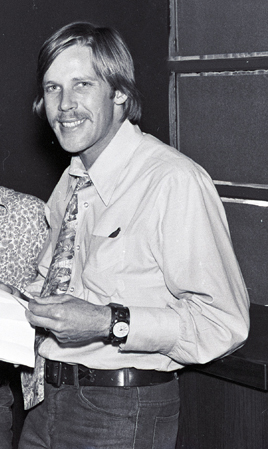
Skip Goucher. Photo copyright Mike Barich, St. Paul
Allan says that Goucher “disappeared” after his short involvement in the Depot, but he shows up at in Tucson, embroiled in his own personal crime spree. “In 10 months in Tucson from Nov. 2, 1971, through July 28, 1972, Goucher was arrested and charged with 12 felonies.” (Tucson Daily Citizen, February 2, 1973)
Superior Court Judge Joe Jacobson was roundly criticized for giving Goucher six years of probation for the three charges he plead guilty to, in exchange for dropping seven other charges. The judge defended his action, and one of his points was, “This fellow promoted rock concerts and got a couple of men to invest $150,000 in a nightclub in Minnesota. He has a potential for good.” (Tucson Daily Citizen and Arizona Daily Star, January 25, 1973). CR states that Goucher died in 2015.
Sharron does not remember Goucher to be a friend of Allan’s but a “hanger on,” and that Allan was very trusting of people. Whatever Skip did, he was around in some capacity in those very early days.
As for Wilson Simon, whom John Fineberg mentions above, his record of crime (mostly drug dealing) could easily make for an entertaining movie, just based on his news clippings alone. The role of Simon and his dirty money in opening the Depot and keeping it afloat has been a matter of speculation but never proven.
THE FIRST MEETING
Danny described what happened next, to the best of his recollection. In October/November 1969, Allan and Skip came to the Times Square nightclub, where Danny was performing, to meet with Danny. Danny had never met them before. Allan said that he had also talked to Ted Mann about using the bus station, and Mann told him that Danny had control of a liquor license and was looking for a financial partner. Danny knew of Allan’s wealthy father Manny, and assumed, like many, that Allan had access to a great deal of money.
Danny agreed to work with Allan, and they made several agreements:
- They would own the business equally.
- They would have weekly meetings.
- Allan would handle the business with Ted Deikel, who was his brother-in-law and worked for his father Manny.
- Abby Rosenthal would be the General Manager.
- Danny would control the entertainment.
- Allan would put in $150,000 cash and guarantee the balance of his $400,000 – $500,000 contribution by signing for credit.
- Skip Goucher would help with booking.
- Amos Heilicher would provide the games (pinball, etc.).
- Eddie Phillips of Phillips Liquor would supply the beer and liquor.
- Dick Shapiro would do most of the booking.
- Danny’s Reasons would only play on Mondays, but Danny would work to find local acts. Danny acknowledged that the nature of his band was not the kind that they were looking for at the Depot.
THE COMMITTEE
These intrepid young people (and they were very young!) banded together to form a corporation called The Committee, Inc. The information below includes a lot of detail about shares, board titles, contracts, lawsuits, etc., which may seem picaune, but they help piece together a story that has been subject to misinformation, speculation, accusation, and frustration. I’ll try to keep it moving.
AGREEMENT TO ORGANIZE THE COMMITTEE
The City of Minneapolis has on file a document entitled “Agreement to Organize a Corporation,” signed (but not notarized) by Allan and Danny on January 2, 1970. It is a detailed, 11-page document that spelled out their intention to form a corporation to be known as “The Committee, Inc.” The document makes reference to Bylaws; I have not found any Bylaws, but this document contains the kinds of terms that would normally be in a set of Bylaws.
This document is odd in that it refers to Danny as “Daniel,” which is not his legal name.
The Agreement to Organize provided that:
- The corporation had 25,000 shares of common stock with a par value of $1.00 each.
- Shareholders had one vote for each share held.
- Allan was to pay $20,000 in cash for 2,000 shares of stock.
- Danny would pay $10,000 for 1,000 shares of stock. Payment would be made by:
- assigning the liquor license to The Committee, which he did on January 20, 1970.
- executing a promissory note to The Committee for $6,500, payable in three years.
- The Committee would assume the debt of $11,500 to Jack Dow for the liquor license. (See below)
- Allan agreed to purchase a $25,000 “note of the corporation.”
- Allan and Danny were the Committee’s two directors, and would remain directors as long as they were shareholders.
- Allan was Chairman of the Board.
- Danny was President.
- Sharron Fingerhut was Secretary and Treasurer.
- Allan and Danny would have joint operating responsibility of the Committee’s business.
- Allan and Danny would be employees of the Committee for an indefinite period.
- Allan and Danny “shall render a substantial amount of time and effort to the corporation.”
- All cash reserved or held for expansion or capital improvements had to be approved by both Allan and Danny.
- Cash in excess of that needed for ordinary working capital would be distributed to Allan and Danny quarterly.
- Any sale of stock had to be approved by both parties.
- Each director had the right of first refusal to buy stock from the other if he wanted to sell.
- Sale of stock must be paid in cash.
- In the event of voluntary or involuntary liquidation of the corporation, if all amounts owed to Allan have been paid, Danny would have a 30-day first option to buy the liquor license for $10,000 cash.
ARTICLES OF INCORPORATION
The Articles of Incorporation that created the Committee, Inc. were drafted on January 9, 1970. They provide that:
- Total shares were 25,000 with a par value of $1.00 each.
- Shareholders had one vote for each share held.
- The first Board of Directors were Allan and Danny.
- The term of office was until the first meeting of the shareholders.
This document must have been drafted by the same person who wrote the “Agreement to Organize a Corporation,” above: Danny was again listed as Daniel Stevens, which is not his legal name and his “Post Office Address” is listed as “Oak Park Heights, St. Paul, Minnesota,” which was not and never has been remotely his address.
THE LIQUOR LICENSE
The story of the liquor license may seem like a technicality, but not only would we not have First Avenue if not for what happened in 1970, but the story has some interesting twists and turns. Well, they were interesting to me, anyway… And my research has answered some lingering questions that have puzzled those involved for years. I hope you enjoy the story.
BUYING AND SELLING
Although the practice is illegal now, back in 1970, in order to get a liquor license, one had to buy one from someone who already had one. This unwritten policy went back to 1961, when the State bulldozed Skid Row, leaving dozens of bar owners with liquor licenses but nowhere to relocate. In order to compensate them for their loss, it was determined by the City Council that the liquor license holder could sell his license to someone else if he could not find a place to relocate. (Minneapolis Star, June 30, 1970)
Throughout the sixties, bar owners were buying and selling their liquor licenses to each other, and Minneapolis’s application to become a new owner of a license asked if the request was a transfer from another establishment – and if so, was there any consideration paid for the transfer, i.e., did the buyer pay anything or promise to pay anything to the seller. Apparently even though the buying and selling was not illegal, the City wanted to know how much was being paid for these transfers. Many times these amounts were even published in the paper.
Eventually this practice was upheld by the Minnesota State Supreme Court in a case decided in 1969. Robert A. Saugen was the owner of the Aces Lounge, famous for having the record number of pockets picked within three hours. This fine establishment was taken by eminent domain and demolished in 1966 to make way for the 35W/I-395 (then Highway 12) interchange. He was allowed $39,500 for his building, but nothing for his business, which included his liquor license. He tried three times to relocate the Aces, but was met with Not In My Back Yard each time. Instead of selling his liquor license, which he could have easily done, he sued the State for compensation for his loss of business as well as the bricks and mortar, and kept appealing until the case went to the Minnesota Supreme Court. The value of the Aces Lounge was stipulated as $17,500.
And he won! The Court ruled that a liquor license had a monetary value if the owner of the license could not relocate his business elsewhere. The Minneapolis Star seemed stunned: “Court apparently places ‘price’ on liquor licenses,” read the headline of June 4, 1969.
By State law, Minneapolis only had a finite number of liquor licenses. The City Council had a policy on limiting the number of bars in the City by not issuing any licenses that had been turned back in. This made licenses difficult to get, and prices ranged from as low as $6,000 in 1971 to as high as $30,000 several years before. (Minneapolis Tribune, April 10, 1971)
DOW TO DANNY
Enter Jack Dow. Henry Jack Dow was a prominent businessman, President of the Louis F. Dow Co. The company, started by his father, made calendars and advertising specialties. In August 1965, Will Jones reported that the company was the country’s major manufacturer of Beatles merchandise!
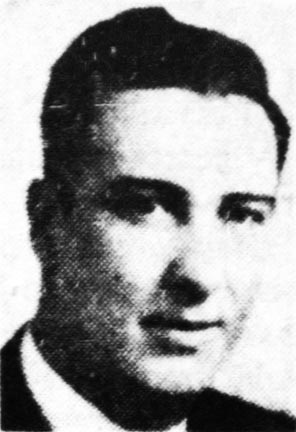
Jack Dow, 1959
Dow owned two Minneapolis properties:
The Hotel Hastings, was located at 32 N. 12th Street. Dow bought the hotel in 1959 with partners Wheelock Whitney and Cedric Adams.
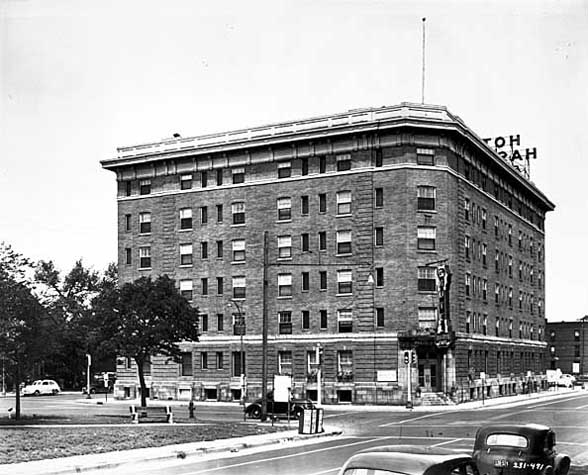
Hotel Hastings, 1948. Photo courtesy Minnesota Historical Society
The hotel had two music venues: the Mar-Key Club, which was a private club, and the public Coral Reef Bar in the basement. Danny’s Reasons performed at the Hotel starting in January 1969 (alternating with the Nite Caps, Wednesdays – Saturdays) until early April 1969.
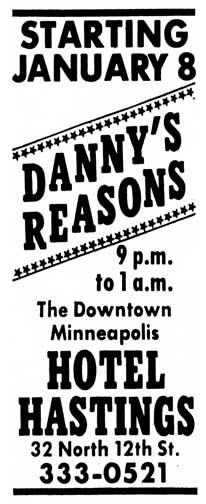
Minneapolis Tribune, 1969
The building was taken by eminent domain in September 1969 and demolished in November 1969 in order to build the eastbound lanes of Highway 12 into downtown. This made the liquor license owned by Dow for the Coral Reef Bar in Hotel Hastings available. (Dow intended to move the Mar-Key.)
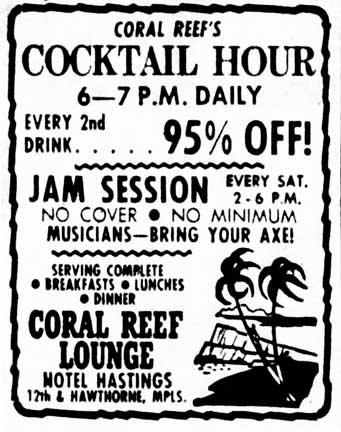
Minneapolis Star, August 23, 1967
Dow purchased 724 – 4th Ave. So. in about August 1969. It had operated as Diamond Lil’s from about July 1966 to 1969. Jack Dow allowed Danny to take over the lagging Diamond Lil’s and run it as a rock club called Times Square from October 1969 to about February 1970. It became a popular place for national musicians who were in town to come and hang out after their shows (Danny assured the police that no alcohol was served after legal hours). (DS)
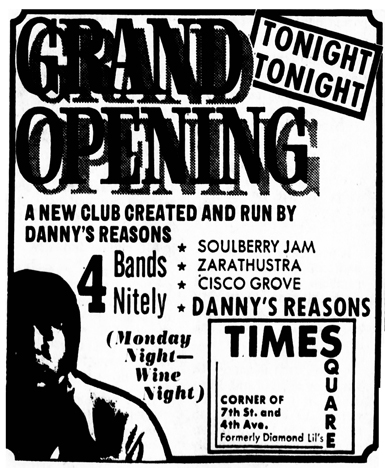
Minneapolis Star, October 3, 1969
Dow and Danny did not have a written lease for Times Square. Although it was doing well, Dow wanted to rent the building to the people who were interested in putting the Friar’s Dinner Theater in, so he paid Danny a bonus for leaving. (DS)
Another account said that Times Square “failed.” (Allan Holbert, Minneapolis Tribune, February 8, 1970)
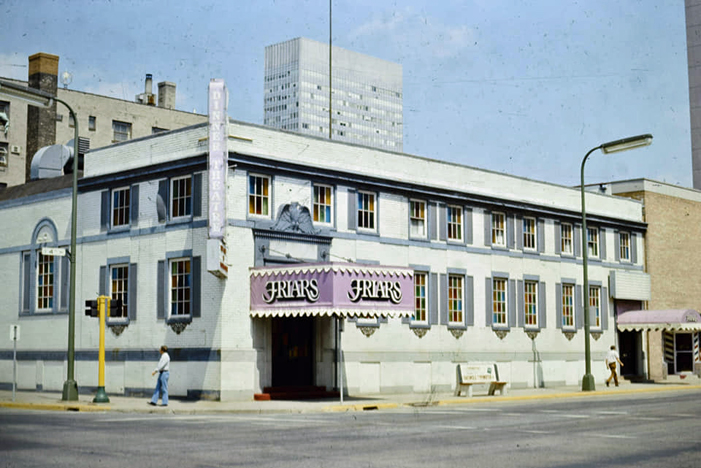
Friar’s Club, 1974. Photo courtesy Hennepin County Library
A series of other failed endeavors came and went into the space before the building was blessedly demolished in 1981.
PURCHASE AGREEMENT
Out of friendship and gratitude for bringing in business through Times Square and the Hotel Hastings, Jack Dow decided to sell his liquor license for the Coral Reef Bar in the Hotel Hastings to Danny. (DS)
This was done via a Purchase Agreement, dated January 16, 1970, which called for Danny to pay Dow $11,500 in installments of $300 per month, beginning on April 1, 1970, and ending on July 1, 1971. I received a copy of this document from Danny and also from Hennepin County in conjunction with documents involving a lawsuit.
Under the terms of the agreement, Danny could transfer the license to a corporation if:
- The corporation took on the payments.
- The corporation had a lease to a location acceptable to the City as a bar.
- Danny had to be the owner of at least one-third of the stock of the corporation and be an employee of the corporation.
DANNY TO THE COMMITTEE
As permitted by his contract with Dow, four days later, on January 20, 1970, Danny transferred his interest in the liquor license to The Committee, Inc. via a Bill of Sale. Danny provided me with a copy of this document.
Danny made the transfer to The Committee on the advice of his legal counsel in order to avoid the liabilities of Dram Shop laws that hold bar proprietors responsible for damage or injuries, etc. caused by customers who got drunk at their establishments. (DS)
APPLICATION TO THE CITY
On January 26, 1970, The Committee submitted its written application for a Class A liquor license to the City. The top sheet of the seven-page application shows Danny’s signature. (MLD)
Highlights of the application include:
- Amount of authorized capitalization: $25,000
- Amount of paid in capital: $30,000
- Allan was Chairman of the Board and Director, with 2,000 shares
- Danny was President and Director, with 1,000 shares
- Sharron was Secretary-Treasurer, with no shares
- Owner of the building was Guild Management Co. (probably Ted Mann’s property management company)
- Sources of Income, Allan: Trust, Fingerhut Manufacturing Co.
- Sources of Income, Danny: musical entertainment (Danny’s Reasons)
- Sources of Income, Sharron: none
- Trade Name to be used: The Depot
- No employees hired yet
NO CONSIDERATION?
The application included a request for a transfer of the license of the Hotel Hastings directly to The Committee. It required a statement as to whether or not any consideration, money or property had been or agreed to be, or will be, paid or given or exchanged, and if so, a statement of the amount of the consideration. The response was “No consideration of any kind has been or will be paid by anyone to anyone for the transfer of the license sought to be transferred.” On the line for the signature of the former licensee was typed Hotel Hastings, Inc., and signed H.J. Dow. On a separate page, the following is under his signature: “For no special consideration, this on-sale liquor license number 48706 is hereby transferred by Hotel Hastings, Inc. to The Committee, Inc. as of January 26, 1970.” Danny’s signature is also shown on the application in the section requesting the transfer of the license from the Hotel Hastings to the Committee.
But Wait! Wasn’t there clear “consideration” (payment) for the transfer of the liquor license – the $11,500 agreed to in the Purchase Agreement of January 16, 1970? At the time it was perfectly legal for Dow to sell his license to The Committee. So why did he say that he didn’t?
The application for the license as a whole shows the signatures of Allan and Danny.
APPROVAL
Danny remembered that he had to go to an interview as a part of the application process, meeting with the head of licensing, who was was Dick Short, Bob Short’s brother. He says that Dick was unhappy with the involvement of Allan, because he had no experience in the entertainment business. Danny came back a second time, this time with his father. Allan never met with Short, saying to Danny that it was Danny’s dream, and that he should handle it. (DS)
Sharron remembered that it was the other way around, and the City was wary of Danny’s reputation. Through his daughters, I asked Allan about this version of events, and his response was “Sharron’s recollection is correct. No one was wary of my inexperience.”
All we know for sure is that the application was approved very quickly, in January or February 1970.
CHANGE IN LICENSE POLICY
Jump ahead for a minute to October 29, 1971. Not long after Danny had signed the Purchase Agreement to pay $11,500 for Dow’s license, the Minneapolis City Council announced it was now changing its policy and not allowing transfers from one person to another. Instead, all unused licenses had to be turned into the City, and new bar owners would have to buy them from the City for a fee of $2,500. The change was made because the City had a stockpile of 10 licenses, and most urban renewal had been completed. Although this meant that someone who had paid a high amount for their license would not be able to sell it to get their investment back, Alderman Erdall said “that will happen to all tavern owners whenever the policy is changed, so it may as well be changed now. (Minneapolis Tribune, October 30, 1971)
HOTEL HASTINGS, INC. vs DANNY H. STEVENS
Ahead even further, on June 19, 1973, Jack Dow sued Danny, saying that Danny had only paid $3,900 of the $11,500 he owed Dow for the license under the Purchase Agreement of January 16, 1970.
Danny answered that:
- He had not received anything in return for the $3,900 he had paid.
- The Purchase Agreement was illegal and against public policy (a reference to the 1971 change in policy noted above).
- The Bill of Sale of January 20, 1970, had transferred the responsibility to repay the debt to The Committee, so he was no longer responsible.
Danny must have then realized he had paid $3,900 for nothing, so in October 1974 he filed his own lawsuit demanding:
- a refund of the $3,900 that he had paid from Dow, and
- that if Dow won a judgment in court, it was up to The Committee to pay any funds because of the Bill of Sale.
As part of the overall settlement between Danny, The Committee, American Scene, and Allan, executed on May 14, 1975, it was agreed that if Danny, with his own money, continued to fight Dow’s suit and if Dow won, The Committee, American Scene, and/or Allan would pay the judgment.
I wasn’t sent any further information on this case from the court, so I can’t report on how this ended.
DANNY’S LICENSE?
For years, it was rumored/believed/speculated that the liquor license somehow belonged to Danny, or that he controlled it in some way. To be clear, the liquor license was never in the name of Danny Stevens, but was transferred directly from the Hotel Hastings, Inc. to The Committee, Inc.
However, the Purchase Agreement of January 16, 1970, certainly indicates that Jack Dow fully intended to convey his liquor license directly to Danny to enable Danny to start his own club. Danny says that Dow “held” it for him and that Dow made it available to the Committee upon Danny’s request.
It is important to know and remember that Danny was the one who facilitated the transfer of the liquor license to the Depot. Without the license, there would have been no club.
THE DEPOT
From this point until 1976 I will be indicating who signed what documents regarding the liquor license and what they say – this may seem tedious, but it is important to know:
- The members of The Committee
- The titles of the members
- The distribution of shares
as these facts will be a matter of dispute later on. Please bear with me.
On March 2, 1970, Allan’s signature is shown on the annual renewal of the liquor license. On the application the type of entertainment was characterized as “contemporary music.” (MLD)
On March 26, 1970, Danny’s signature is shown on the supplemental affidavit that listed the names of the officers, directors, and stockholders of The Committee, Inc. (MLD):
Danny was listed as President, holding 1,000 shares
Allan was listed as Chairman of the Board, holding 2,000 shares
Sharron was listed as Secretary, holding 0 shares
Allan was listed as Manager
1971
On February 26, 1971, Allan’s signature is shown on the application to renew the liquor license. The type of entertainment was characterized as “Rock.” (MLD)
On February 25, 1971, Allan’s signature is shown on the supplemental affidavit that listed the names of the officers, directors, and stockholders of The Committee, Inc. (MLD)
Allan was listed as Chairman of the Board, Secretary, and Treasurer, holding 2,000 shares.
Danny was listed as President, holding 1,000 shares.
Sharron Fingerhut was not listed.
Joe Sandino was listed as Manager.
The Depot closed on June 14, 1971.
THE “SCENE WEST”AND THE MINNESOTA SCENE
This is a kind of bizarre chapter in the history of the Depot/Uncle Sam’s. In the end it turned out to be a tale “full of sound and fury, signifying nothing,” as a bemused Mr. Shakespeare might have said, but what fun to discover it!
The American Scene, Inc. (later to be known as American Events, then American Avents), was a company run by brothers Donald, James, and Richard Fraser, who opened their first club in Cincinnati in the mid-1960s. (CR) They would go on to franchise a string of discos in Buffalo, Houston, Des Moines, Lincoln, Dallas, Davenport, Boston, Detroit, Long Island, Providence and Syracuse. And as we’ve seen in Part II above, they would eventually take management control of our venue during the Uncle Sam’s era in 1972.
But in 1971, they created an abortive plan to take control of the club and liquor license that had some legal holes in it and didn’t pan out.
Making an agreement to manage the club was one thing, but the American Scene was apparently intent on controlling the liquor license as well. Unfortunately for them, a holder of a Minneapolis liquor license had to be located within 75 miles of Minneapolis. So the American Scene created a new company, The Minnesota Scene, Inc., to do just that.
The Minnesota Scene was incorporated as a Minnesota corporation on August 31, 1971. The Articles of Incorporation, on the same day, have several interesting provisions. (SS)
- The first among several purposes listed was “To own, operate, manage, promote, advertise and franchise bars, taverns, cocktail lounges and dance halls.”
- It stated that it had the right to have one or more offices in any state.
- Its registered office was CT Corporation System Inc., Minneapolis. CT Corporation is a company specifically designed to act as registered agents for companies in other states, and still exists today.
- Minnesota Scene was incorporated with 100 common shares, but the shares had no par value. The initial capital was $1,000.
The first directors were three executives from American Scene in Cincinnati.
The Articles of Incorporation provided that meetings of shareholders could be held outside the State of Minnesota and that the books of the corporation may be kept outside of the State of Minnesota. Er, you mean, Ohio???
PURCHASE AGREEMENT
On October 20, 1971, a Purchase Agreement was executed between Allen Fingerhut on behalf of The Committee, Inc. and Richard S. Fraser on behalf of The Minnesota Scene, Inc.
This document, which was not notarized, was provided to me by Danny, who states that he was not involved with or aware of the negotiations behind this business deal, despite the fact that he was President of The Committee. Danny also speculates that this deal must have taken at least two to three months to put together. (DS)
The agreement (and I summarize) was for The Committee to sell two bars downstairs, one bar upstairs, the contents of the office, and the liquor license to the Minnesota Scene for $15,600. The sale was contingent on the approval of the transfer of the liquor license by the City, which had to take place before November 30, 1971.
On November 5, 1971, The Minnesota Scene, Inc. registered its office and/or agent, again appointing CT Corporation Systems, Inc. the company that provided in-state addresses. The document was signed by President Richard Fraser and Secretary D. Michael Poast of The Minnesota Scene. Both, of course, executives of The American Scene.
MINNESOTA SCENE’S APPLICATION
On November 22, 1971, Timothy Hugh Hawkins, identifying himself as the President of The Minnesota Scene, Inc., signed an application for a Class A liquor license for the property. If this is connected with the Purchase Agreement of October 20, above, which stipulates that the deal is off if the City doesn’t approve the transfer of the liquor license before November 30, Mr. Hawkins has only given himself eight days to get a Minneapolis liquor license approved. (MLD)
Features of the application:
Amount of authorized capitalization: 100 shares, $10 common stock. Amount of Paid-in capital: $1,000.
Subsidiary of any other corporation? No [Was this true?]
Purpose of corporation: Operation of bar or nightclub
Officers:
Timothy Hugh Hawkins: Director, President, Secretary, and Treasurer; 100 shares.
Michael Poast, Cincinnati, Director, no shares.
The application revealed some interesting factoids about this mysterious Mr. Hawkins: (I was unable to find any sign of him in Ancestry.com or in two people search databases.)
- He was born in 1946 in Ohio.
- He listed his address as 3151 Chowen Ave. So. This was a brand new apartment building in 1971.
- After four years of college, he was a Publicity Entertainer – Entertainer Publicity? for a TV station in Cincinnati for a year or so.
- Then he was an entertainer for Waylan Jennings, Inc. in Nashville for less than a year.
- Next he was back in Cincinnati as a cook at a restaurant called BoJo’s.
- That was in 1971, as was his stint as Supervisor at Silco, Inc., also in Cincinnati.
- On December 13, 1968, he was convicted of Petit Larceny in Springfield, Ohio, “for taking case of Kroger’s frozen orange juice, value $9.36.”
His three business references were Ted and Marvin Mann, and the First Produce State Bank, which was across the street from the Depot.
The deal was that “Applicant corporation [The Minnesota Scene, Inc.] will pay a rental based, in part, on a percentage of gross income.” The application didn’t say who the applicant would pay the rental to.
The new name of the club would be “The Scene West.”
NO CONSIDERATION?
The application asks whether any money or other consideration has changed hands with regards to this requested transfer of the license, and if so, how much. Typed on the form is “No consideration of any kind has been or will be paid by anyone to anyone for the transfer of the license.” This statement was affirmed by (typed) THE COMMITTEE, INC. and the signatures of Allan and Danny are present.
Two problems with this:
First, as we have seen, as of October 29, 1971, new clubs had to get their licenses directly from the City, and could not purchase them from other license owners.
Second, if you look at that Purchase Agreement again, isn’t the liquor license included in a transaction that clearly has The Committee, Inc. identified as the “Seller” and The Minnesota Scene, Inc. as the “Buyer?”
WITHDRAWN
So, perhaps being told of the new policy regarding transfers, and not wanting to go to jail for perjury regarding the consideration, Mr. Hawkins wisely withdrew his application on December 21, 1971. Hawkins did this by letter to the Chairman of the License Committee on the City Council. He even had the foresight to include the request: “In the event I am entitled to a refund of the application fee, I would appreciate it.” There is no letterhead.
And Minnesota Scene went back to Ohio. For now.
P.S. Ever keeping his ear to the ground, Connie Hechter of The Insider, apparently got wind of the plan to open the club with recorded music. But Connie was also an old-school musician, and couldn’t conceive of a dance hall with no live musicians. The days when the all-powerful Musicians Unions were requiring ghost musicians on the payroll were rapidly disappearing.
December 1971, Insider: “Backers from Ohio may reopen The Depot as a discotheque. The only catch is that the Minneapolis Musicians’ Union, only a block away, will not sit back and allow the huge club to run dancing without live musicians.”
1972
TRANSITION
The 1972 liquor license renewal yields a surprise. On February 28, 1972, The Committee’s attorney, Melvin I. Orenstein of Lindquist & Vellum, transmitted the 1972 liquor license renewal form and fee of $1,750 to the City. His cover letter noted, “The Depot has been inactive for the last seven or eight months. The company is now in the process of trying to sell its business and would, however, like to renew its license pending the completion of the sale.” (MLD)
Danny states that he was never informed about any impending sale. And indeed that never happened.
On February 29, 1972, Danny’s signature is shown on the application to renew the liquor license. The type of entertainment was characterized as “Nightclub. (MLD)
On February 29, 1972, Danny’s signature is also shown on the supplemental affidavit that listed the names of the officers, directors, and stockholders of The Committee. (MLD)
Allan was listed as Board Chairman, holding 2,000 shares.
Sharron was listed as Secretary-Treasurer, holding 0 shares.
Danny was listed as President, holding 1,000 shares.
Allan was listed as Manager.
DANNY RESIGNS FROM THE BOARD
In the City’s files is a document dated March 24, 1972, the shows Danny’s signature. The document is not on letterhead or notarized. It reads:
I hereby resign as director and president of The Committee, Inc., effective as of the date hereof.
Danny denies that he signed this letter and says he did not resign. (DS)
In Danny’s files is a document entitled “CERTIFIED COPY OF RESOLUTION OF SHAREHOLDERS AND DIRECTORS OF THE COMMITTEE, INC., dated February 22, 1973. Committee Secretary Sharron Fingerhut certified that on March 24, 1972, a resolution was adopted by an action of Shareholders and Directors taken without a meeting:
RESOLVED, that the following persons be, and hereby are, duly elected to serve as directors of the corporation for the ensuing year and until their successors are elected and qualified:
Allan Fingerhut
Sharron Fingerhut
RESOLVED FURTHER, that the following persons be, and hereby are, elected as officers of the corporation to serve for the ensuing year and until their successors are elected and qualified:
Allan Fingerhut – President and Treasurer
Sharron Fingerhut – Secretary
This February 22, 1973, resolution is odd in a number of ways:
- It did not directly reference Danny’s resignation letter of March 24, 1972.
- Does it mean that Danny’s letter, and the “action taken … without a meeting,” and the adopted resolution were all the same thing?
- The resolution is dated a year after the action it describes.
AMERICAN SCENE
Finally the Committee found a solution to its financial and management problems. On April 7, 1972, the Committee and American Scene signed a document called an Entertainment Franchise Agreement (EFA), which provided for American Scene to take over the management of the club and turn it into a link in their Uncle Sam’s chain of discos.
I have not seen the Uncle Sam’s EFA, I don’t know who signed it, and cannot guarantee that a copy still exists. It would be interesting to know the terms – not to mention have it for its historic value. Here’s what we do know:
- American Scene virtually “took over” the business, paying the rent, employees, providing an on-site manager, making entertainment decisions, etc. (SM)
- Contrary to several reports, Allan did NOT sell his shares in the Committee to American Scene. (BF, AF)
- This is borne out by the affidavits filed each year with the liquor license renewal applications, which clearly list Allan still owning his 2,000 shares to 1975, and 100 Percent of the shares (3,000) thereafter. (MLD)
- After Danny’s exit in 1975, there had to be someone within a 75-mile radius of Minneapolis on the board in order to retain the liquor license.
- The liquor license continued to be in the name of The Committee. (MLD)
- The business continued to be owned by The Committee.
American Scene made the place over into a “Saturday Night Fever” type disco (although the film wouldn’t be released until 1977), with a lighted dance floor, screens and projectors, and all the accoutrements that made it just like its other Uncle Sam’s locations.
[American Scene] had a notion that they could build a chain of dance clubs around the country in much the same way that Ray Kroc had built McDonald’s: by treating all markets alike and standardizing everything, including the name. (CRM)
As for the finances,
Frank believes Fingerhut [the Committee?] made about $100,000 out of the gate, thanks to some shrewd accounting work and the fact that American Scene invested a lot of money to make over the venue. With help from federal investment tax credit laws, the club owner would benefit from everything the Cincinnati investors put into the place.
“All the equipment [American Scene] put in, Allan got paid for it. He got the credit, write-offs, everything,” Frank said. “After I did that deal, I walked out of that meeting and immediately went to a phone and called Allan and said, “Listen I just did this deal for you, and you will not believe it. Don’t say anything about it. Don’t f**k it up!” The deal was that American Scene would keep ninety-five percent of the revenue to manage the place, and Allan was going to get five percent for essentially doing nothing. “They ran it for five or six years with that deal,” Frank said. (CR)
UNCLE SAM’S opened on July 1, 1972.
1973
On February 28, 1973, Allan’s signature is shown on the application to renew the liquor license. The type of entertainment was characterized as “Nightclub.” (MLD)
On February 22, 1973, Committee attorney Melvin I. Orenstein’s signature is shown on the supplemental affidavit that listed the names of the officers, directors, and stockholders of The Committee, Inc. (MLD)
Allan was listed as President and Treasurer, holding 2,000 shares.
Sharron was listed as Secretary and Vice President, holding 0 shares.
The space for title after Danny’s name was left blank, and he was shown to hold 1,000 shares.
In a March 1973 profile of Danny, Michael Anthony wrote that Stevens owned the liquor license for the club [not true], and owned a part of the club with Allan Fingerhut, going back to the Depot days [true]. (Minneapolis Tribune, March 4, 1973)
DANNY SUES FOR DAMAGES
On October 12, 1973, Danny sued The Committee and The American Scene, alleging:
- Danny has been a substantial minority shareholder and, at some times a director and officer of The Committee.
- American Scene agreed to hire Danny’s Reasons at Uncle Sam’s at least once/week as long as the club used live entertainment.
- For all other entertainment, Danny would receive a commission that would ordinarily be received by a union booking agent.
- Danny was told that acquiescing to the EFI “would be of substantial financial benefit” to him as a shareholder.
- Danny was told that he “would receive substantial financial benefits” for himself by being employed as a musician and booking agent.
- American Scene and The Committee have failed to keep records of financial matters.
- The EFI is fraudulent because the club was totally operated by The American Scene and the Committee had no role.
- It was impossible for American Scene and/or the Committee to make the accountings and payments provided for in the EFI.
- Danny does not have access to records that would tell him the amounts that were due to him.
- Danny has been substantially damaged by the failure of the Committee to enforce its rights and privileges as set forth in the EFI.
Because he had no access to financial records, Danny was unable to determine the amount of his damages and the amount owed to him by either party, so he sued each party for $100,000. He also demanded that each party provide him with an accounting of what they owed him, and when those amounts were determined, to pay them to Danny.
On October 23, 1973, The American Scene and The Committee answered:
- There was no breach of contract.
- Uses the word “was” to describe Danny as a director and officer of The Committee.
- Said it “Does not have information sufficient to form a belief as to the truth or falsity” of Danny’s claims that he was told that he would be hired to play at Uncle Sam’s and be paid a booking agent commission for other bands.
- Denied the rest of the allegations and stated “that the complaint did not state a cause of action or a claim upon which relief can be granted…”
As part of their overall settlement with Danny on May 14, 1975, The American Scene agreed to pay Danny $2,500 and The Committee agreed to pay Danny $4,000 to settle this case. The payments from The Committee were to be made in 18 monthly installments.
1974
EARLY DAYS
On February ?, 1974, Allan’s signature is shown on the application for renewal of the liquor license. The type of entertainment was characterized as “Discoteque (Dancing).” (sic) (MLD)
On February 1, 1974, Allan’s signature is shown on the supplemental affidavit that listed the names of the officers, directors, and stockholders of The Committee, Inc. (MLD)
Allan was listed as President, Treasurer, and Director, holding 2,000 shares.
Sharron was listed as Secretary and Vice President, holding 0 shares.
Danny was listed as Director and Shareholder, holding 1,000 shares.
Peter C. Budziciek was listed as Manager. He was an employee of American Scene.
1975
On February 26, 1975, Allan’s signature is shown on the application for renewal of the liquor license. The type of entertainment is characterized as “Live.” (MLD)
On February 24, 1975, manager Patrick T. Lyons signed Allan’s name to the supplemental affidavit that listed the names of the officers, directors, and stockholders of The Committee, Inc. (MLD)
Allan was listed as President, holding 2,000 shares.
Sharron was listed as Secretary and Vice President, holding 0 shares.
Danny was listed as Shareholder, holding 1,000 shares.
DANNY LEAVES THE COMMITTEE, INC.
On May 14, 1975, a special meeting of the board of directors and shareholders of The Committee, Inc., was held at the offices of Lindquist & Vennum, 4200 IDS Center, which was the office of Committee attorney Melvin I. Orenstein. Present at the meeting were Orenstein, Allen, and Byron Frank. Minutes of the meeting state “notice thereof having been given as per the appropriate provisions of the By-laws of the corporation.” (MLD) (I do not have a copy of the bylaws of The Committee, nor were they available from the Minnesota Secretary of State.)
The key paragraph in the minutes is as follows:
Allan Fingerhut reported than an agreement had been entered into between The Committee, Inc., the American Scene, Inc., Allan Fingerhut, and Danny Stevens under the terms of which Danny Stevens has sold all of his stock in The Committee, Inc. to Allan Fingerhut. In addition, Stevens has released the Committee, Inc., as well as the American Scene, Inc., from all claims which he has or may have had against the said firms and persons and has also dismissed all lawsuits against the said firms and persons. A copy of the said agreement is attached hereto and expressly incorporated herein.
A copy of the agreement was obtained from the City of Minneapolis. It was signed by Danny, Allan, Allan on behalf of the Committee, and John S. Keate, signing as President of The American Scene. The signatures are not notarized on the copy I received.
The agreement’s provisions included:
- Danny sold his 1,000 shares to Allan for $2,500.
- The American Scene was to pay Danny $2,500 to settle Danny’s lawsuit for performance and booking fees. (filed in October 1973)
- The Committee was to pay Danny $4,000 to settle the same suit as above. Payment was to be made in 18 monthly installments.
- The Committee cancelled the $6,500 promissory note that Danny owed to the Committee as partial payment for his 1,000 shares, as provided for in the Agreement to Organize dated January 2, 1970.
- Danny provided a general release of all claims against The Committee, The American Scene, their respective directors, shareholders, officers, agents or employees.
- Danny provided a waiver of any and all rights under the Agreement to Organize, dated January 2, 1970.
- Allan, the Committee, and the American Scene shall each provide a general release of all claims against Danny.
- If Jack Dow won his lawsuit against Danny for the remainder of the $11,500 provided for in the Purchase Agreement for the liquor license of January 16,1970, The Committee, American Scene, and Allan would pay the judgement as long as Danny continued to defend the lawsuit with his own money. (This was discussed previously under January 20, 1970.)
The minutes of the May 14, 1975, meeting provided that the agreement was “adopted, approved, ratified and confirmed on behalf of The Committee, Inc.” In addition, the minutes provided that the President was authorized to cancel Danny’s stock certificate for 1,000 shares and issue a new certificate for 1,000 shares to himself. Danny has a copy of Allan’s new certificate for 1,000 shares, dated May 14, 1975. Allan was elected as the sole Director and President for the ensuing year and until his successor was elected.
Also received from the City is a document entitled Mutual Release. It was also signed on May 14, 1975, by the parties listed above; the document is also not notarized. The document is a mutual release between Danny and the Committee, American Scene, and Allan from all actions, causes of actions, suits, proceedings, debts, dues, contracts, judgments, damages, claims, and demands.
The agreement called for the closing date of the transaction (payment of funds due immediately, release agreements, surrender of Danny’s stock certificate) as April 5, 1975, a curiosity since that date comes before the date of the meeting, agreement, and mutual release.
Consistent with the requirement that the Committee pay Danny $4,000 in 18 monthly payments to settle one of the two lawsuits is Steve McClellan’s memory that he made monthly payments to Danny. Allan instructed McClellan never to be late on this payment, as the agreement provided that the debt would be in default if it was more than 48 hours late. (SM)
Danny does not remember being notified about the meeting of May 14, 1975, signing this agreement, selling his stock, or receiving any payments for it.
1976
ALLAN IS THE COMMITTEE
On February 28, 1976, Allan’s signature is shown on the supplemental affidavit that listed the names of the officers, directors, and stockholders of The Committee, Inc. (MLD)
Allan was listed as (B.C.) (Presumably Board Chairman?) 3000 shares Patrick Lyons wrote in “(2000 last year but sole shareholder).”
Sharron was listed as Secretary, (0) shares.
Patrick T. Lyons was listed as manager. (He was now living at 3151 Chowen, the same place Timothy from the ill-fated Minnesota Scene had lived…)
On March 2, 1976, Allan’s signature is shown on the application for renewal of the liquor license. The type of entertainment is characterized as “Live.” On the application, when asked for full details of any change in officers, stockholders, or the distribution of stock, it said “Danny Stevens Eliminated 6/15/75” This must be a typo, since the meeting and the agreement were ratified on May 15, 1975 and the stock certificate is dated May 15. (MLD)
At the annual meeting of the Committee on June 15, 1976, attended by Allan and Orenstein, Allan was elected as the sole director, President, and Treasurer. Allan remained the sole Director and President, effectively becoming The Committee, Inc., until the company went bankrupt in 2004.
1977
On January 14, 1977, Stephen McClellan’s signature is shown on the supplemental affidavit that listed the names of the officers, directors, and stockholders of The Committee. (MLD) From this point until 2004, Allan was listed as President: 100%, and Stephen T. McClellan was listed as Manager.
On January 20, 1977, Allan’s signature is shown on the application to renew the liquor license. The application asked if there had been any change in the seating capacity, and the answer was “added chairs and tables 950 people.” (MLD)
1978
On January 25, 1978, Allan’s signature is shown on the application for renewal of the liquor license and the supplemental affidavit that listed the names of the officers, directors, and stockholders of The Committee, Inc. (MLD)
On October 8, 1978, Allen’s signature is shown on the supplemental affidavit that listed the names of the officers, directors, and stockholders of The Committee. (MLD)
On October 16, 1978, Allan’s signature is shown on the application for renewal of the liquor license. (MLD)
1979
On October 9, 1979, Allan’s signature is shown on the application to renew the liquor license and the supplemental affidavit that listed the names of the officers, directors, and stockholders of The Committee, Inc. The name of the club at that time was still shown as Uncle Sam’s. (MLD)
1980
THE ASSOCIATES AND 2M
When American Avents was out of the picture (exact date unknown), responsibility for the management of Uncle Sam’s reverted back to The Committee, Inc. By many accounts, Allan was being urged to close the club down and sell it off. Before he could, Steve and Jack Meyers went to Allan’s house and convinced him to let them manage the place for half their salary plus a 10 percent bonus (SM).
Allan consented.
Steve and Jack first formed “The Associates,” and their attorney, Joe Finley, made up a contract for management services for Committee Inc. When Dan Lessard left American Avents, he was added to their Management Agreement. (SM)
Jack famously was made the accountant, not because he had any accounting experience, but because he had been a math major, and in Steve’s eyes that was about the same thing. Jack eventually took courses to learn accounting and served the club well until he retired in 2009.
The photo below was taken from a Facebook page and was not attributed; please contact me if you have credit information.
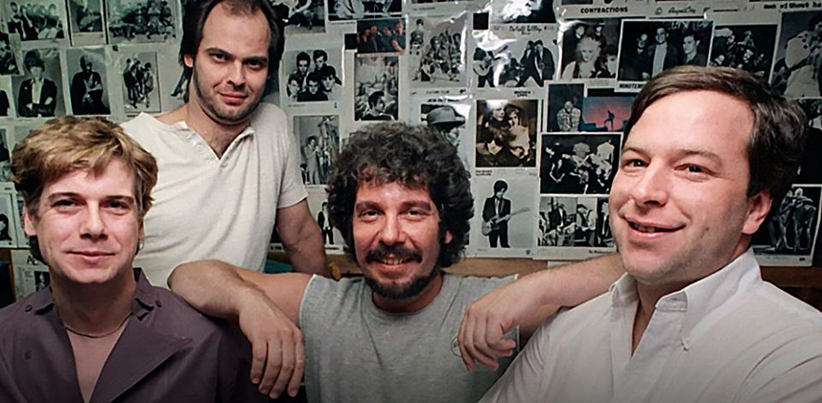
Dan Lessard, Steve McClellan, Allan Fingerhut, Jack Meyers
On December 30, 1982, the three partners filed Articles of Incorporation for a company called McClellan, Meyers & Lessard, Ltd. Documents on file with the Secretary of State show that the company had 1,000 shares, Jack was the registered agent, and Steve was the CEO. (SS)
After several years, internal problems between Daniel Lessard and John Meyers/Stephen McClellan severed the relationship and he was let go. (SM)
On May 8, 1986, Jack Meyers, Secretary of the company, filed a Certificate of Amendment with the Secretary of State, changing the name to 2M, Inc. The last filing (to change the registered office or agent) was made on January 27, 1999. (SS)
When Allan “fired” Steve McClellan and Jack Meyers on June 22, 2004, what he really did was terminate the Management Agreement between The Committee and 2M. Jack Meyers was re-hired by Byron Frank, but Steve McClellan was not. (SM)
SAM’S
Back up to 1980. One of the first things that the new management did was change the club’s name from Uncle Sam’s to Sam’s. It appears to have happened between April 18 and May 4, 1980.
On November 3, 1980, Allan’s signature is shown on the supplemental affidavit that listed the names of the officers, directors, and stockholders of The Committee, Inc. (MLD)
On November 4, 1980, Allan’s signature is on the application for renewal of the liquor license. It was still called The Committee, Inc. dba Uncle Sam’s. (MLD)
1981
On November 2, 1981, Allan’s signature is shown on the application for renewal of the liquor license and the supplemental affidavit that listed the names of the officers, directors, and stockholders of The Committee, Inc. It was now called The Committee, Inc. dba Sam’s. (MLD)
FIRST AVENUE
On New Year’s Eve 1981, Manager Steve McClellan and his staff renamed the club First Avenue.
1983
On July 11, 1983, Allan’s signature is shown on an application for a special license permitting the sale of liquor on Sundays. The application indicates that First Avenue provided grill or sandwich service, 7 days a week, with full seating for 312 and restaurant seating for 92. (MLD)
On November 20, 1983, Allan’s signature is shown on the application to renew the liquor license. Under changes in seating area, it was written, “Changes in fire exits and changes in customer seating area.” (MLD)
2000
F-TROOP
Ted Mann’s company, which still owned the building, told the Committee that it was going to either sell the building or double the rent. It became imperative that the building be purchased in order for the club to continue.
Byron Frank, the Committee’s CEO, formed F-Troop LLC on June 20, 2000. There are various accounts of who the shareholders of F-Troop were, but they were not specified in the Articles of Incorporation, and neither the SEC nor the Secretary of State keep track of shares in privately-held corporations.
F-Troop bought the building from Ted Mann’s Hollywood Theatre Co. on July 1, 2000 for $2.5 million. F-Troop then leased the building back to The Committee. The Committee still owned the business.
Byron Frank and Allan executed a contract outlining their roles at the club, but in September 2003, Allan took Frank to court, alleging that Frank forged Allan’s signature on the document. (Star Tribune, September 13, 2003)
2003
In 2003, revenue plunged nearly 25 Percent, to $3.1 million, Fingerhut says. He urged his associates to shift the club’s strategy by scheduling more DJs and dance nights. But Frank disagreed, insisting that the club remain true to its rock ‘n’ roll roots. Now that his own money was on the line, he was in no mood to compromise — and McClellan and Meyers agreed. “In this industry, you have to roll with it and hang on through the trends,” McClellan says… Fingerhut was horrified when Frank spent some $200,000 on renovations, which included a plush new VIP lounge. (Inc.com)
Byron Frank, identified as President of The Committee “but disputed by TCI” was terminated by Allan on December 25, 2003, according to the Statement of Financial Affairs section of the Bankruptcy Petition.
On October 29, 1982, Allan’s signature is shown on the application for renewal of the liquor license. It was now called The Committee, Inc. dba First Avenue/7th St. Entry. Stephen T. McClellan was listed as Manager. Under changes in seating capacity, there was written, “Permitted occupant load is currently 1,425 (under UBC) and application to have permitted occupant load officially increased to that figure has been submitted.” (MLD)
2004
McCLELLAN AND MEYERS ARE LET GO
On June 22, 2004, Allan terminated the contract of 2M, essentially firing management team Steve McClellan and Jack Meyers. (SM) Steve got the news during the Patti Smith concert that night, packed his things, and left.
Curiously, on the Statement of Financial Affairs section of the Bankruptcy Petition it says that Jack and Steve were terminated from The Committee on July 1, 2003. Jack was identified as the Vice President of The Committee, and Steve as “Manager through 2M, Inc.”
FINANCIAL WOES
Starting in 2002, business fell off dramatically. Inc.com:
“After 9/11, people didn’t want to come out in big groups to see music,” says Meyers. What’s more, R&B and hip-hop had grown increasingly popular in the Twin Cities, making First Avenue’s all-rock format seem outdated. Meanwhile, a slew of new bars and clubs were cutting into the club’s customer base.
Frank had green-lighted a number of raises and bonuses before Fingerhut arrived, increasing the club’s operating expenses. Even worse, Frank, Meyers, and McClellan all filed wrongful termination suits against their former boss, leaving Fingerhut with mounting legal bills.
THE COMMITTEE IS EVICTED
On October 6, 2004, landlord F-Troop sued the Committee for damages in excess of $500,000. This amount may have been what was described as $160,000 in unpaid real estate taxes, overdue rent, and two other lawsuits pending over terminated contracts. (BPA)
Also on October 6, 2004, F-Troop filed an unlawful detainer (eviction) action against The Committee in Hennepin County District Court. (BPA)
New York Times:
Empty nights at First Avenue became desperate ones, and Mr. Fingerhut was behind on insurance, taxes and the rent. Mr. Frank said he had offered to lend Mr. Fingerhut money, but was turned down. But by Mr. Fingerhut’s account and according to a document sent by his lawyer, Mr. Frank’s final offer was instead a push for complete capitulation that would have left Mr. Fingerhut out of the club and saddled with debts.
701 VENTURES, INC.
On October 8, 2004, 701 Ventures, Inc. was registered with the State. (SS) Provisions of the Articles of Incorporation included:
- 701 Ventures, Inc. was incorporated with common 25,000 shares.
- Shares had no par value.
- The registered office was 1225 LaSalle Ave., Apartment 1007, Minneapolis. This is now a condo owned by Byron Frank.
- Directors were specified in the Bylaws. Share percentages are from the License Inspector’s Report of November 18, 2004.
- Byron Frank, President/Director: 51 percent Shareholder
- Steve McClellan, Secretary/Director: 5 percent Shareholder
- John Meyers, Treasurer/Director: 24.5 percent Shareholder
On October 28, 2004, The Committee voluntarily agreed to surrender possession of the building on November 4, 2004. (BPA)
THE COMMITTEE DECLARES BANKRUPTCY
At 1:30 pm on November 2, 2004, The Committee, Inc. filed for Chapter 7 bankruptcy and First Avenue closed. Chapter 7 bankruptcy is a liquidation of a company’s assets with the intention of ending the company, as opposed to a Chapter 11 filing, which is meant to reorganize a company’s finances and keep it going.
The 46-page Bankruptcy Petition (BP) was extremely detailed and was not prepared overnight. It’s anyone’s guess when Allan made the decision to file.
A small, barely noticeable sign posted on the club’s door … announced the closing Nov. 2. Another farewell posted on the club’s Web site offered thanks to the club’s staff and community: “The departing staff wish to thank all of the staff members from the last 30-plus years for their hard work, tears and souls.” (Journal)
The Committee reported assets of $388,238, which included a $50,000 loan from F-Troop, the value of the liquor stock, and the value of insurance policies. The assets of the name First Avenue and the liquor license were listed but were given no monetary value. (BP)
Against those assets were listed $1,404,711 in claims. Allan himself claimed $795,000, which included reimbursement for loans to The Committee and $570 in capital contributions – his personal money he had put into fixing up the club. F-Troop claimed $507,374 in back rent, real estate taxes, fees, etc. (BP)
There were five lawsuits and other proceedings pending against The Committee. (BP)
WHO WAS THE COMMITTEE?
There are at least two versions of the makeup of the Board of Directors of The Committee at the time it declared bankruptcy.
According to the official record maintained by the Licenses and Consumer Services Division, the corporate structure of The Committee, Inc. was as follows: (License Inspector’s Report, November 18, 2004)
- Byron Frank, President
- Allan Fingerhut, Vice President and Sole Shareholder
- John Meyers, Treasurer
- Steven McClellan, Manager
But the BP reported:
- Allan Fingerhut, President, CEO, and Chairman of the Board
- Rose Fingerhut, Board Member
In addition, the BP asserted that:
- Byron Frank was the President (but this was disputed) until he was terminated on December 25, 2003.
- Jack Meyers was Vice President until he was terminated on July 1, 2003.
- Steve McClellan was Manager until he was terminated on July 1, 2003.
Regardless, Allan was the sole shareholder of the Committee, as he had been since 1975.
TO COURT
Immediately on November 2, 2004, the case was assigned to Judge Robert J. Kressel. All assets of The Committee Inc. were in put into a bankruptcy trust, including the name First Avenue and the liquor license. John R. Stoebner was appointed Bankruptcy Trustee. Stoebner’s job was to represent the Committee’s Estate.
PURCHASE AGREEMENT
Things moved quickly. On November 5, 2004, Stoebner negotiated a Purchase Agreement with F-Troop. (BPA) For a purchase price of $100,200 (a price that Stoebner essentially set), F-Troop agreed to buy and the Trustee agreed to sell:
- Personal property and leasehold improvements
- The right to the name First Avenue
- The existing liquor inventory
- The right to use the Committee’s liquor license, subject to “certain requirements imposed by the City of Minneapolis”
- The right to be added to the existing insurance policy
Stoebner agreed to use Committee funds to reassemble/repair the existing boiler, and gave F-Troop an administrative expense rent claim of $7,400.
F-Troop agreed to honor pre-paid ticket sales on a case-by-case basis.
Stoebner agreed to assist in obtaining a transfer of the liquor license pending the approval of a new license.
The BPA was signed by Stoebner as Trustee, and Byron Frank as “Chief Manager” of F-Troop.
On November 8, 2004, Stoebner filed a motion for an expedited hearing, arguing that:
- A Purchase Agreement had been negotiated
- No higher offer had been made
- The value of the assets will diminish rapidly over time
- The Estate would earn significantly less from a liquidation sale
- Delay would incur additional administrative expenses
- A quick sale would allow F-Troop to re-open First Avenue as soon as possible, rehire employees, and salvage as many scheduled concerts as possible
- The beer and wine in the club have a limited shelf life
On November 12, 2004, Judge Kressel held a hearing and granted Stoebner’s motion of November 8, thus approving the terms of the Purchase Agreement of November 5. First Avenue was sold to F-Troop, which now owned both the building and the business.
FINAL ACCOUNTING
On June 19, 2007, Stoebner filed the Trustee’s Final Report and Distribution with the U.S. Bankruptcy Court. The vast majority of creditors received 10.54639 Percent of their claims.
Employees:
- The Bankruptcy Petition stated that “All employees were paid in full prior to filing” and there were no priority wage claims of individual employees other than Allan.
- The Trustee’s Final Report showed that 12 employees had indeed not been paid. These 12 were awarded 100 percent of their claimed unpaid wages.
- Allan’s priority claim of $10,000 for unpaid salary was not awarded.
2M: of $957,600 claimed, $31,639 was paid.
F-Troop: of $300,000 claimed, $31,639 was paid.
Allan and Rose Fingerhut: Although the initial BP indicated that they had a non-priority claim of $785,000 ($215,000 for loans to The Committee and $570,000 for capital contributions), the Trustee’s Final Report lists their non-priority claim as $35,000. Of that, they received $3,691.
In addition, there was an issue about two payments totaling $55,000 that Allan withdrew from the Committee for wages and repayment of a loan. Because they were made within a year of filing of the bankruptcy, they were under the scrutiny of the Trustee. On March 3, 2005, Stoebner filed an “Adversarial Proceeding” against Allan and Rose Fingerhut demanding repayment. Reasons include:
- Allan knew the dire financial straits that the Committee was in, and withdrawing the money would make the Committee even less able to pay its debts.
- Withdrawing the money before the bankruptcy yielded the Fingerhuts 100 percent of the debt, whereas if they had included the debt with the other creditors, they would have only received what turned out to be about 10 Percent of the amount claimed. Trustee Stoebner charged that these were “preferential transfers.”
The issue was settled on July 20, 2005, when Judge Kressel approved the negotiated settlement of the Adversarial Proceeding in which the Fingerhuts, without admitting any liability, agreed to pay the Trustee $35,000 of the $55,000 sought. I mention this issue only because it has been reported erroneously in other secondary sources.
THE LIQUOR LICENSE REDUX
There was still the question of the liquor license. This is a bit confusing – when asked, even the City License Division could not explain how the license was transferred or otherwise reactivated.
Jack Meyers found it difficult to sort it out himself. He said it was easy for he and Steve McClellan to see what was happening, since the real estate taxes weren’t being paid and there was no cash in the money room. Seeing the writing on the wall, they began preparing a new liquor license application in about August 2004. The cost of the fee and attorneys was about $10,000, paid for by Byron Frank. (JM)
On November 18, 2004, Minneapolis licensing inspector Kenneth Ziegler issued a License Inspector’s Report on 701 Ventures’s application “for new ownership of an existing on-sale liquor establishment to be effective on January 1, 2005.”
The License Inspector’s Report described the machinations that went on in order for 701 Ventures to use The Committee’s license:
- On November 11, 2004, F-Troop leased the building to 701 Ventures.
- 701 Ventures then sub-leased the building to The Committee.
- The Committee entered into a Management Agreement with 701 Ventures, specifying that 701 Ventures would operate the business (presumably with The Committee’s license) until 701 Ventures had gained approval of its own, new license, estimated to be January 1, 2005.
- The License Division recommended that The Committee be permitted to resume business, with the management assigned to 701 Ventures.
This appears to mean that only the Committee could use the Committee’s license, and 701 Ventures would have to involve the Committee in order to operate under its license until 701 Ventures got approval of its own license.
However, the terms of the bankruptcy gave F-Troop the right to use the Committee’s liquor license, and did not call for a transfer.
Jack Meyers remembers that, since there was only about six weeks left on the old Committee license, it was decided to allow First Avenue to reopen using that one, and then by January 1, 2005, the new one prepared by Jack and Steve would be approved. Mayor R.T. Ryback, an enthusiastic concert-goer at First Avenue, famously made a phone call to the License Division, and made sure that the club had a valid license in place so it could reopen.
THE END OF THE COMMITTEE
With the bankruptcy, the Committee, Inc. was essentially out of business, its shares worthless, and no business to conduct.
The final death knell came on January 8, 2007, when the Minnesota Secretary of State officially dissolved the company for failure to file the required annual renewal. This is basically a housekeeping measure to get dormant corporations off the books. With that, the Committee, Inc. was no more.
And that, my friends, is what I found out about The Committee, Inc. If I’ve gotten anything wrong, please contact me before you file a lawsuit! My heart is pure and I mean nobody any harm. Thank you!
IN MY OPINION
In a brief departure from my studied objectivity:
I would like to acknowledge and thank the founders of this venue, who took an old bus station and made it into a place to “get down” instead of “get out of town” (gee that’s corny): Mr. Danny Stevens and Mr. Allan Fingerhut. Without their vision in 1970 we would have no First Avenue today.
I believe that Allan and Danny should have stars on First Avenue. Each of them would like to have that honor and recognition, and I believe they more than deserve it. It is part of their personal legacies and part of Minneapolis history.
Also, Danny Stevens was more than Allan’s nameless “Partner with a liquor license,” as referred to on First Avenue’s website. This is a travesty that could easily be changed.
And Steve McClellan, who gave 33 years of blood, sweat, and tears, to the entertainment mecca in three of its phases, should have a statue. A big statue. Which iteration of Steve, I don’t know. Maybe one with what he calls his “porn star mustache.” He was pretty cute then! Let’s get on that, shall we?
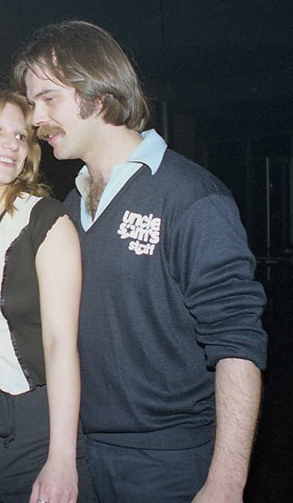
Steve McClellan – photo copyright Steven Laboe
Thank you.
Jeanne Andersen
APPENDIX: STEVE McCLELLAN DAY
The community showed its support for Steve on March 22, 2015, when the Mayors of Minneapolis and St. Paul concurrently declared it “Steve McClellan Day.” (Star Tribune, March 22, 2015)
The proclamation read:
Whereas Stephen Thomas McClellan — born and raised in Minneapolis, Minnesota — attended De LaSalle High School and The University of Minnesota, took a temporary job as a part time bartender at Uncle Sam’s to earn money for his college tuition; and
Whereas, Stephen will be celebrating his 65th birthday and will be so honored by friends, family and others, Sunday, March 22, 2015 at one of the oldest Twin Cities watering holes; and
Whereas, he served on the boards of Minnesota Public Interest Research Group, Cedar Cultural Center Minnesota Music Academy, KFAI Radio Downtown Warehouse Association; and
Whereas, Stephen served as primary talent buyer, marketing director, general manager of First Avenue for over 30 years; and
Whereas, he broadened the Twin Cities music scene to an internationally recognized arena for music including groups like Africa’s King Sunny Ade; and
Whereas, Stephen has worked across multiple mediums of performance art, principally music; and
Whereas, Stephen has helped nurture and develop local music groups such as The Jayhawks, Husker Du, The Replacements, Suicide Commandos, The Suburbs, The Wallets, Prince, The Time, The Flamin’ Oh’s and out of town artists who were unheard of such as REM, U2, Nirvanna, Red Hot Chili Peppers, Greenday and many others, booking acts which he believed in;
and
Whereas, Stephen made First Avenue a household name internationally after Prince filmed “Purple Rain” at First Avenue; and
Whereas, he is a staff member of the Music Business Faculty at McNally Smith; and
Whereas, Stephen continues his imprint on musicians of all styles, creating his non-profit Diverse Emerging Music Organization (DEMO) to help aspiring musicians
NOW, THEREFORE, I, BETSY HODGES, Mayor of the City of Minneapolis, do hereby proclaim March 22, 2015 as:
STEPHEN MCCLELLAN DAY IN THE CITY OF MINNEAPOLIS
The party was held (where else?) at the Schooner.
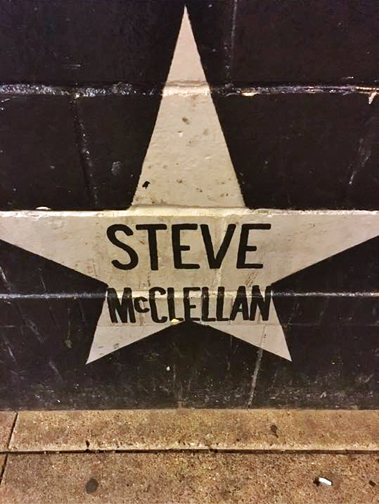
Save
Save
Save
Save
Save
Save
Save
Save
Save
Rondo and Western, April 1936. Bessie Pierce, Proprietor. In August 1937 the proprietor was listed as Bessie Massengale.
Diamond Jim’s was at 801 Sibley Memorial Highway in St. Paul – also described as on Highway 13 east of the 35E bridge.
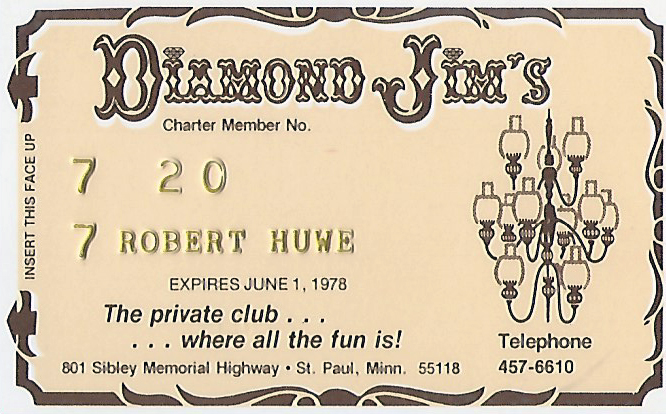
Bob Huwe was a Charter Member. Card courtesy Jan Huwe
Bill Conlan on Lyfmap:
Back around May 1963, my bandmate, Pat Gallivan, and I drove down to upper Lilydale where a new private club named Diamond Jim’s was being finished. We met the manager, Kelly Turgeon, and I picked up a membership application. The dues were $35 annually and, being a charter member, they were to remain at that amount forever. I kept up my membership until at least 1980. The original membership card was a goldenrod color. I can’t find my original but am posting a copy of my second year’s card.
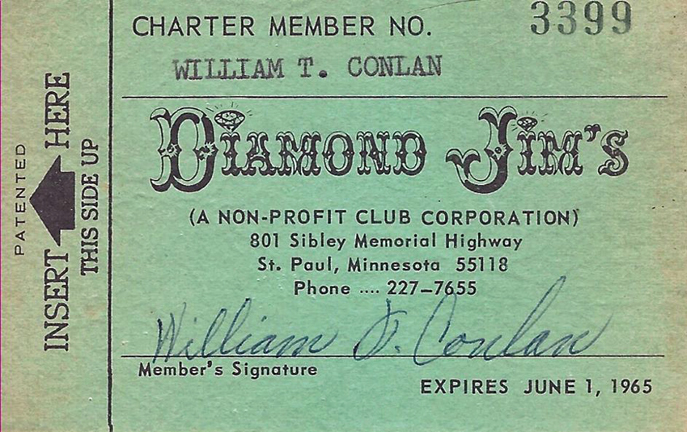
Courtesy Bill Conlan via Lyfmap
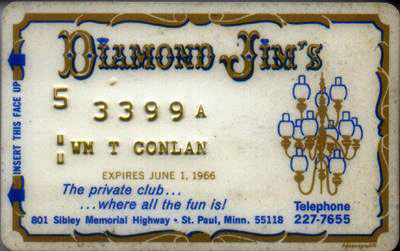
Bill’s card from 1965
One of the most memorable aspects of Diamond Jim’s was the Girl on the Swing. Facebookers remember that one of the women on the swing was Kim Fransen of Mendota Heights.
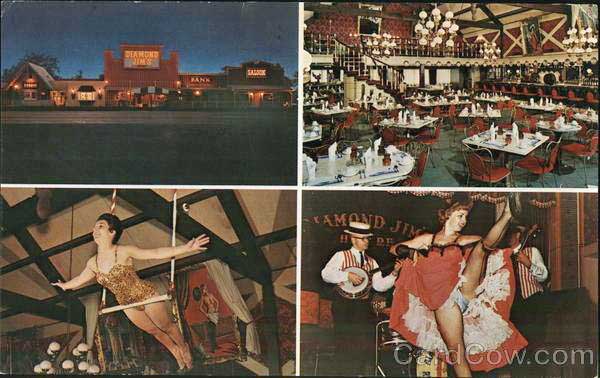
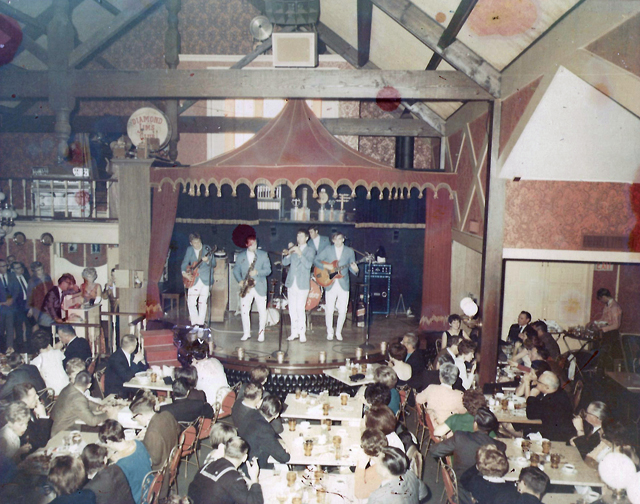
Photo courtesy Jan Huwe
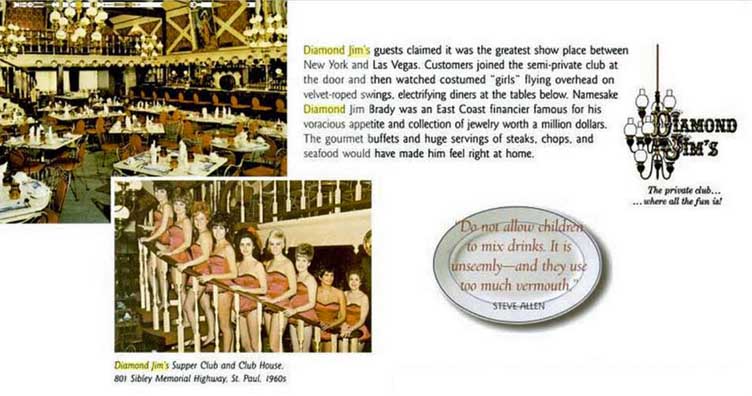
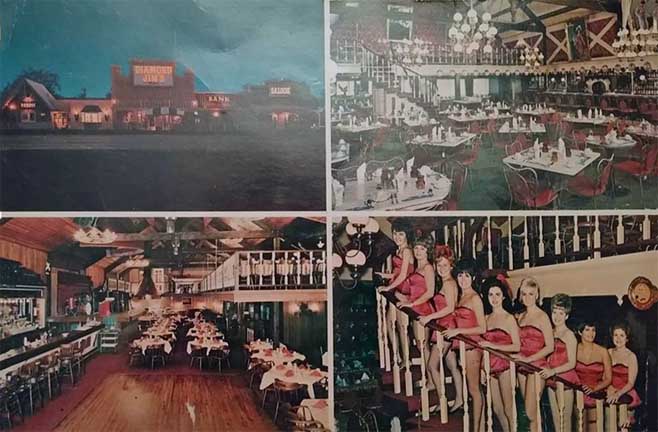
People seem to have a lot of mementos of Diamond Jim’s.
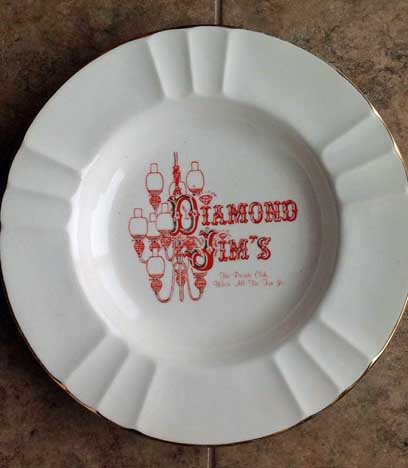
Ashtray from the collection of Mark Youngblood
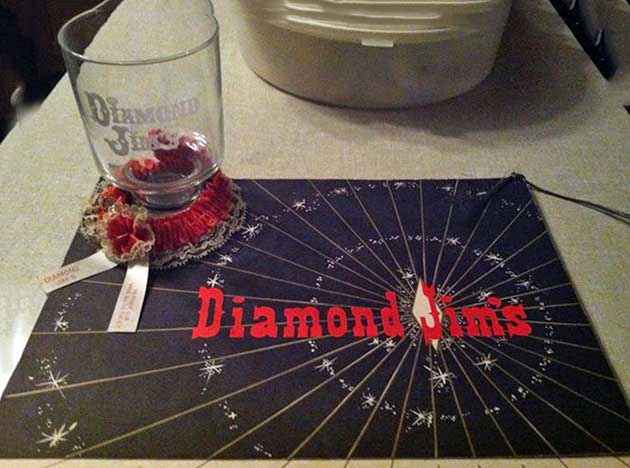
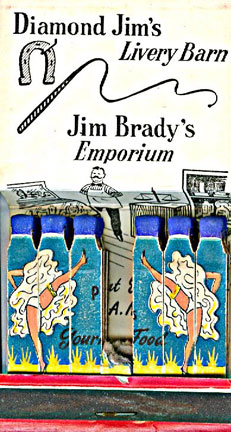
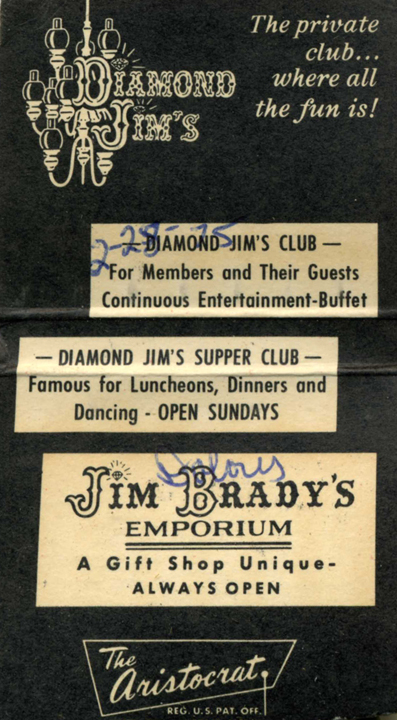
In about December 1981 Diamond Jim’s became Cassidy’s on the Bluff.
In 2020 it was the Joke Joint.
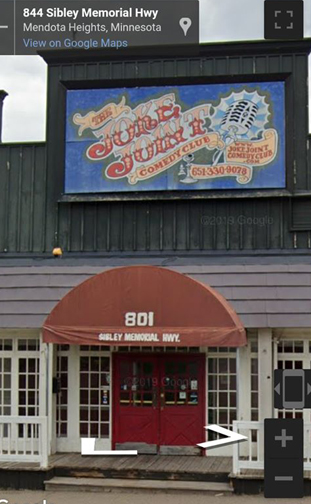
Google Image
Dick’s was a bar – or a series of bars – located at 574 Rice Street in St. Paul. It may not have had music until after 1974, but I was alerted to it by a loyal reader, and got much help from my friends on Facebook, so I just had to look it up!
THE BUILDING
The earliest ad found in the newspapers was placed on October 29, 1892, when some bereft person wanted his Lost Hound Dog back.
By December 1894, the site was the A.W. Sonnen & Co. Drug Store, at least through March 1905. Then the early St. Paul papers stop and we have to rely on Minneapolis papers.
In November 1924 it was the W.R. Stewart Drug Store.
PETE’S BAR
At this point we rely on Minneapolis reporters and their crime reports.
In June 1940, Peter Adikowski was the proprietor of an unnamed Tavern. A 1953 report called it Pete’s Bar, so I’ll go with that.
DICK’S HORSESHOE BAR
From 1945 to 1962 it was Dick’s Horseshoe Bar, as described in the obituary of its proprietor, Richard P. Adikowski. Jim Froehlich found these wonderful tokens from Dick’s, from 1959, on the Internet.
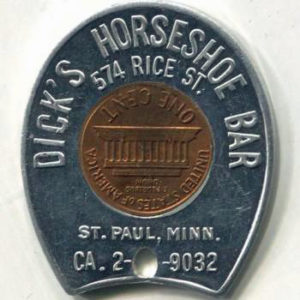
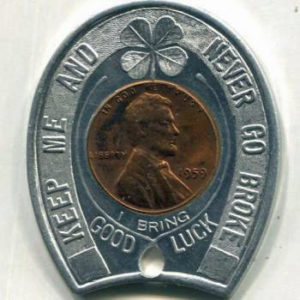
CY’S HORSESHOE BAR
One crime report in June 1965 gave the place Cy’s Horseshoe Bar.
CREA’S HORSESHOE BAR
This name came from the folks on Facebook.
HANK’S HORSESHOE BAR
I had this one before – in 1973 this was a Country bar.
HORSESHOE BAR
Perhaps after that it became tedious to keep naming the bar after the owner, or maybe it was the age of corporate ownership, who knows? It appears that the next hit was in January 1984, when it was only referred to as the Horseshoe Bar. Same in May 1982, when there was definitely live music playing.
TWISTER’S BAR
If this is the same place (given as 574 N. Rice Street), the building’s roof collapsed from the snow accumulated during the Halloween Blizzard of 1991. The building was described as 95 years old, making its building year 1896. It reopened in January 1992.
The building was demolished and replaced with a new one with the address of 580 Rice Street.
Matt Dietsch’s Hall was located at 601 Western Ave. No. in St. Paul.
It was built in 1890, and run by Mathias Dietsch from 1902 until his death in 1937.
The brick building had two stories: a downstairs used as a tavern, and an upstairs open hall.
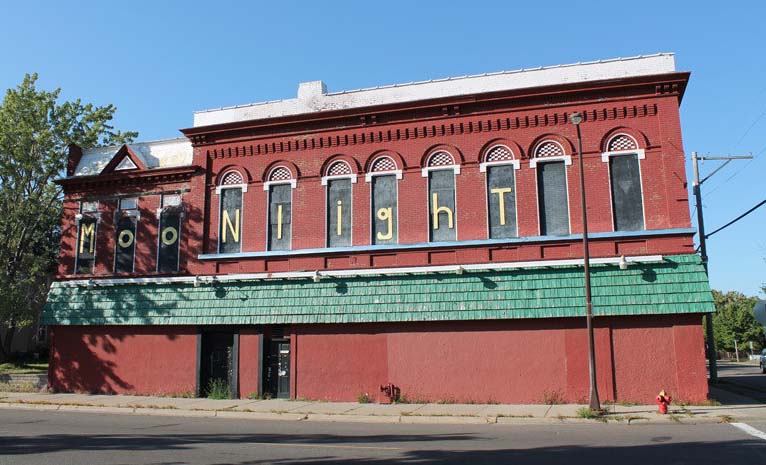
Photo courtesy St. Paul Historical Society
UPSTAIRS
Dietsch’s Hall was used for dances, meetings, and boxing bouts – at least until 1915, when a contestant was killed in pugilistic battle. I found references to Dietsch’s Hall in the Minneapolis papers until October 1961.
Wilebski’s Blues Saloon
The Wilebski Brothers bought the building in 1979. It had been idle for several years.
1979 – 1980: Weekend disco
May 1981 – June 1982: Wilebski’s Brother’s Bar – Top 40
October 1982: Wilebski’s Blues Saloon
October 1986: Wilebeski’s Blues Saloon to Blues Saloon
October 1999 – March 2010: Blues Saloon
June 2000 to October 2003: Lucy’s Saloon was a gay country place.
2006: Diva’s Overtime Lounge
12/31/2009: Wilebski’s re-opened
August 14, 2010: Wilebski’s moved out
DOWNSTAIRS
February 1945 to October 1969: Lenahan’s Bar/Hall
2004 to 2010: Moonlight Magic. Its license was revoked.
The building was demolished in or closely after 2014.
24 Hennepin Ave. New in 1973 – country.
Please see More Down Stairs.
Don’s Owl Club was in Hamel in 1955.
1 mile west of Twin Cities Arsenal on Highway 10. Ken and Betty nightly in 1969.
Much of the information for this page comes from the October 2021 Newsletter of the Westonka Historical Society, written by Elizabeth Vandam.
THE HOLLOW
Only a short stretch long, the Hollow, as the locals still call it, was a section of Sunset Drive along the shore of West Arm on Lake Minnetonka in Spring Park. Incredibly, there were two hugely popular jazz venues on each side of this small stretch of road from about the 1940s to about 1970: The Downbeat was on the north side, and the Lakeview was on the south. Patrons came from all over the area (at the time a 25 minute drive from Downtown Minneapolis) to hear some of the biggest and best purveyors of jazz in the world. Some even came by boat!
THE DOWNBEAT
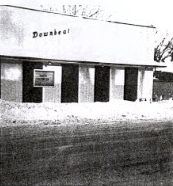
Undated photo courtesy Stan Straley
Jack Mellon owned the bar in 1954.
Dick and Jenny Bruzek bought it in 1954 and it flourished from then until the late 1960s.
Stan Haugesag played trombone there in August 1956.
In July 1957, Percy Hughes was in residence.
On June 9, 1959, Will Jones reported that the big news in Spring Park was “the driving two-trombone work of George Myers and Byron Snow.” The club’s quartet had been working on using the two-trombone sound since the previous September, using the arrangements of Kai Winding. Winding himself had been by to listen and approve.
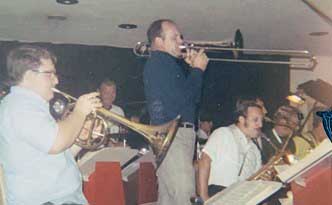
George Myers on trombone. Photo from Myers family, via Westonka Historical Society
In 1960, the house band featured four trombones, as did Winding’s septet. Winding performed at the Club on May 25 and 26, 1960.
FAN MAIL FROM SOME JUNIOR
The Downbeat was catching on with the college crowd. An article in the Minnesota Daily appeared by Paul Boike, identified as a jazz critic and a junior. Since he had graduated from high school in 1958, the undated review would probable date to 1959 or 1960. For some reason Boike deemed the Lakeview a “disaster area,” but
For the rest of you who have some accurate idea of what the world is all about, let me recommend the Downbeat Club and urge my recommendation upon you in the strongest terms. If you like jazz a lot or just somewhat, the Downbeat is the biggest ball presently available in this area. And only on Sunday.
The reason for this is a big, muscular, swinging band under the direction of George Myers. One night of listening to a band like this sets you up for the whole week. It’s that good. Myers’ band is a full jazz orchestra capable of frenetic, up-tempo screamers and beautiful, consummately danceable ballad jazz. It is a band composed of the premier jazz talent of the Twin Cities, the very best men in the area all in a bundle.
… Myers has tenor-men Bob Crea and Ed Boike, altoist Don Rustad, trumpeter Jack Coan and trombonist Byron Snow, all excellent soloists. Individually and collectively, these men blow the kind of music that has been so long absent from this area as to be almost forgotten. Yet the experiences of hearing them is not one of recollection. It’s something fresh, a first-time thing.
On May 20, 1962, trombonist and bandleader Si Zentner came to the Downbeat. Ad below courtesy Robb Henry.
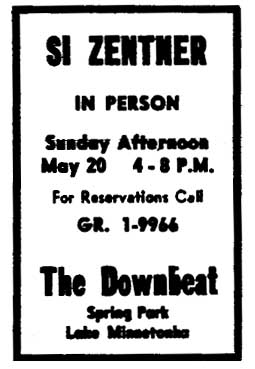
Minnesota Daily, 1962
Winding returned on Sunday through Tuesday, October 14 to 16, 1962. The Sunday show ended at 8 pm, and the George Myers septet with singer Dickie Mayes took over until midnight.
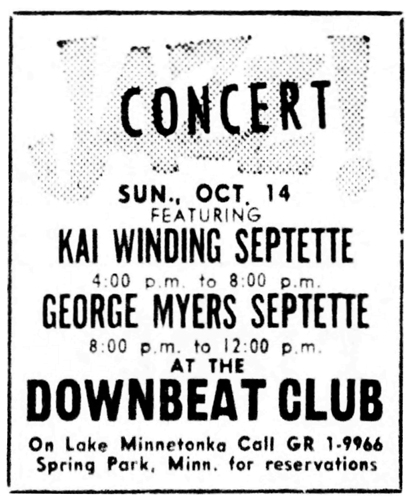
Minneapolis Star, 1962
On May 9, 1963, Woody Herman and His Big Band made a one night stand at the Downbeat.
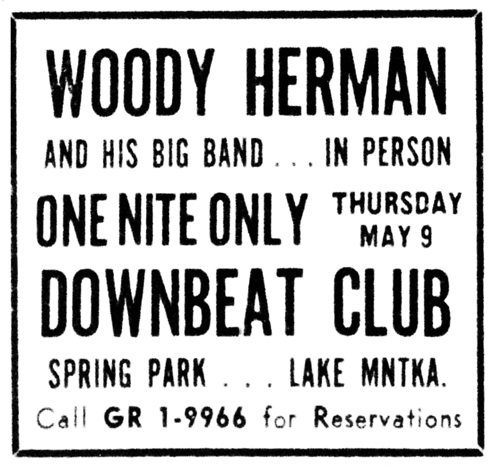
Minneapolis Star, 1963
Woody Herman returned on October 22 and 24, 1963.
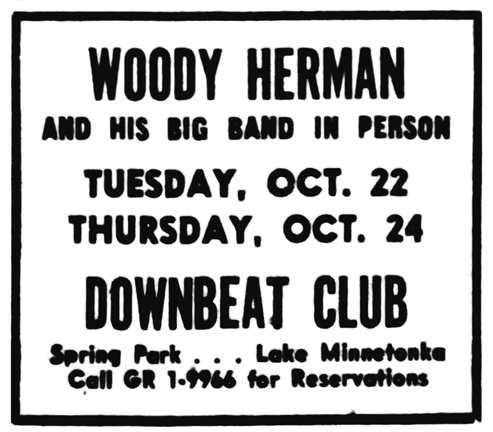
Minneapolis Star, 1963
On March 17, 1964, Bob Murphy reported that the club resumed live entertainment for the season, with Dickie Mayes and his 13-piece band performing. Mayes would play Sundays from 5 to 9, and the George Myers Septet had the Saturday spot from 9 to 12:30.
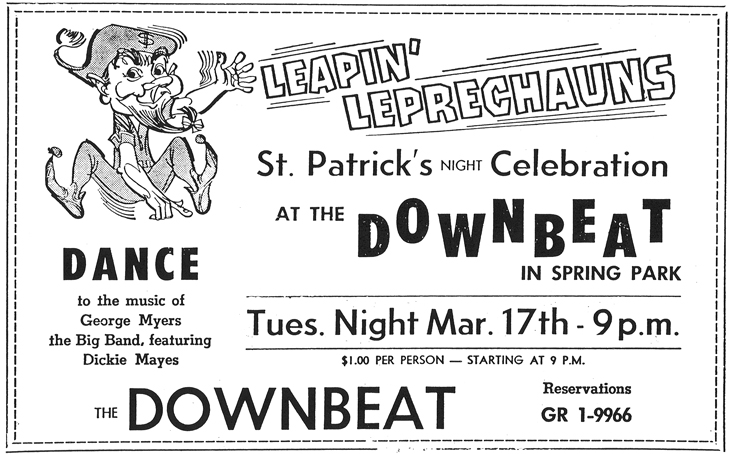
Ad from Minnetonka Pilot, Mound, March 1964, courtesy Westonka Historical Society
Apparently jazz was not the only thing on the music menu, as the ad below from the Minnesota Daily indicates. There is no date other than the year 1964.
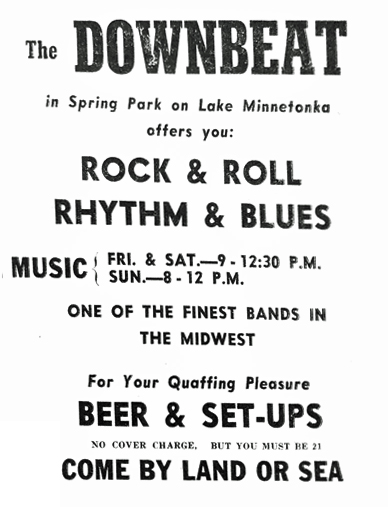
Minnesota Daily, 1964
Si Zentner was yet another trombonist with a Big Band. He performed at the Downbeat on June 26 to 28, 1964.
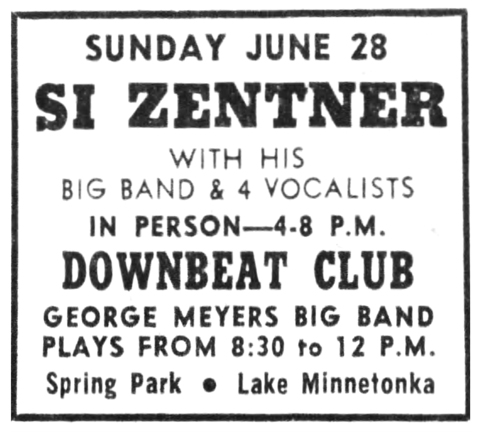
Minneapolis Tribune, 1964
Jimmy Dorsey’s Band came through on August 14 to 16, 1964, featuring Lee Castle.
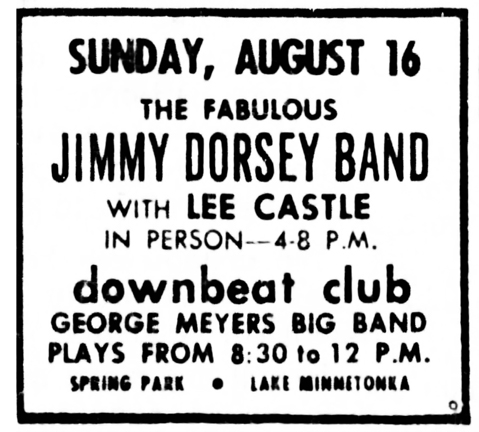
Minneapolis Star, 1964
Will Jones reported on June 2, 1965, that Leigh Kamman had begun tape recording the George Myers Big Band and broadcasting the tapes on KQRS and KQRS-FM on Friday and Saturday nights from 10:30 to 11:00 pm.
Will Jones dedicated his entertainment column in the Tribune to the clubs in Spring Park on June 13, 1967, perhaps the last time they were mentioned. He noted that in George Myers band one could find Jack Coan, who was also one of the heralds who blew the silver trumpets that summon Guthrie theatergoers to their seats. Another was Dave Karr, who played saxophone and flute while following the actors around in the Guthrie play “The Thieves’ Carnival.” And the great Percy Hughes, the bandleader in charge of the dance music at the Point, was here sitting in as a sideman. A stellar group indeed.
An article about revamping the Spring Park docks, dated October 26, 1967, said that “the old Downbeat is being remodeled” into a new restaurant.
In 1970, the Bruzaks sold the bar to Robert Iverson. In September 1971, Iverson was scheduled to open the Dockside Supper Club after extensive remodeling. On Tuesday evening, September 14, 1971, two weeks before the Grand Opening was scheduled, the old Downbeat burned to the ground.
The entire Hollow is gone now, replaced by Rockvam Boat Yards.
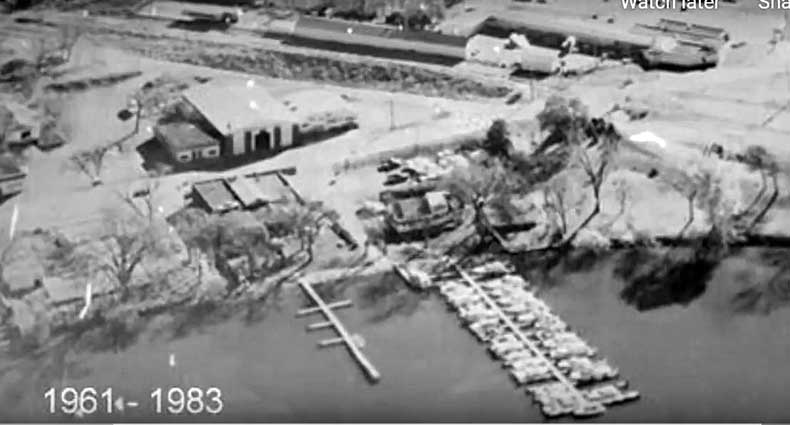
Local artist Stan Straley provides us with a wonderful view of the Downbeat in his painting of the Hollow back in the 1960s, below. Stan explains: “It is a commission I did for the mayor of Spring Park. The Westonka Historical Society had given him a print of Dick Maw’s painting [of the Lakeview – the yellow building] and he wanted me to paint the other side of the street to match it. He made a print of it and gave it to the city to hang in city hall next to the Maw print.” (The Dick Maw print can be seen on the Lakeview page.) The original of the painting below, and prints as well, are available for sale on Stan Straley’s website.
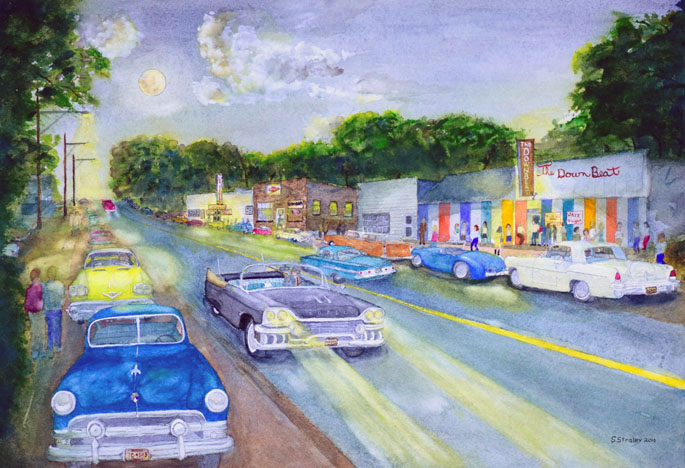
Painting courtesy Stan Straley
The Downtowner Motel was located at 400 So. 7th Street (a/k/a 625 4th Ave. So.) in Minneapolis.
When built in 1960, it had 64 rooms, according to the City’s permit card. The permit card also showed two stories when built, three stories when demolished, and the picture looks like four stories?
In 1963 this motel was owned by Marshall Sloane.
There were apparently several bars/clubs in the building.
EDDIE’S LOUNGE
Eddie’s Lounge featured local jazz musician Hank Hazlett and top name entertainers such as Dizzy Gillespie. In 1962 the LaBombas performed Caribbean and Latin music – “See and Learn the New Dance Craze Linbow and Basa-Nova!”
DAVY JONES’ LOCKER
Davy Jones’ Locker opened in July 1961 and featured a lingerie show which curiously no women went to. In 1962 acts included Junior Walters and Ike Cole, Nat King Cole’s brother. From Davy Jones’ Locker one could see into the pool, and in 1963 Sloan tried to hire girls to don bikinis and frolic for the businessmen; although the Trib reported that Minnesota girls proved too modest, a June 1963 ad did advertise “Exciting cocktail lounge famous for its underwater swimming shows.” One could ask for one’s favorite Pirate Girl for their Shipwreck Specials.
Jazz trios every night except Sunday; in July 1963 the management presented the Lee Evans Trio with Betty Nese, “a special treat as a way of thanking Minneapolitans for their patronage. The Trio has held leading engagements in New York and Las Vegas in addition to television appearances and three popular recordings.” In 1971 or so it was a jazz club with Kenny Horst and his combo as the house band.
Davy Jones’ Locker advertised heavily in the Minneapolis papers.
SULTAN’S HAREM CLUB
The Sultan’s Harem Club may have been a private club requiring an annual membership. In 1967 you could see belly dancers.
THE CAPTAIN’S GALLEY
The Captain’s Galley sounds like a restaurant. In 1967, and perhaps earlier, Terry and the Pirates provided music for a Go Go. (1965 was the big year for Go-Go)
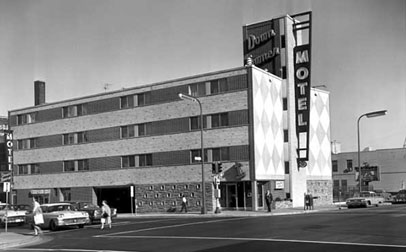
Downtowner Motel, 1966. Photo Minnesota Historical Society
The 52 x 108 x 36′ building was demolished in December 1978.
The Drake Hotel was at 416 So. 10th Street in Minneapolis as a luxury hotel in 1926. At the Rathskeller in 1967 there was dancing nightly to the Bradfords, making their premiere US appearance (they were from England). They instituted a new rock policy in August 1969; just before that were the Four Kaye Brothers.
The building was badly run down and used as a homeless shelter. It is apparently still there.
Oh boy, was Dreamland a popular name for entertainment venues! I’ll name a few and provide links to pages as appropriate.
MINNEAPOLIS:
Dreamland Theater: 329 Plymouth Ave., October 7, 1911.
Dreamland Studio: 221 So. 5th Street, October 29, 1911.
Mrs. Beck’s Dreamland: 723 Nicollet Ave.
Dreamland Hotel: 21 North Washington Ave., July 30, 1914.
Dreamland Dance Hall: 315 Fifth Street So.
New Nicollet Dreamland: 723 Nicollet Ave. – February 1924
Dreamland Cafe and Annex: 3755-57 Fourth Ave. So – 1939. A.B. Cassius
ST. PAUL:
Dreamland Theatre: 167 N Concord Street
Dreamland Dance Hall, 47 Eighth Street
The Dreamland Cafe was located at 3755 Fourth Ave. So.
THE BUILDING
3755 – 3759 Fourth Ave. So. was located in the heart of South Minneapolis’s thriving black community. The 60′ by 41′ brick veneer building was built in 1921.
Early businesses included:
- Speigel-Krane Drug Store: May 1922 – November 1928
- Moore Plumbing and Heating: July – August 1922
- Cafe: 1931
- Restaurant: 1935
DREAMLAND
The Dreamland Club opened on December 15, 1939 and was owned by A. Brutus Cassius and Thel Collins. Current addresses are 3759 (built in 1900) or 3753 (built in 1920).
At the beginning it was evidently primarily a cafe, serving only beer and soft drinks and not mentioning entertainment in the ads found in the Minneapolis Spokesman.
In April 1941, Mr. and Mrs. Cassius were named in an ad as Proprietors.
A “Dance for Grown Ups” was advertised for February 10, 1946, at the Dreamland Annex – no address was given in the ad. Music was provided by Irving Williams and his ex-Navy Band.
In 1946/1947 Cassius sold Dreamland to his nephew, Wyatt C. Pierro, a redcap at the Milwaukee Railroad Depot for $7,500. Pierro was running the cafe with his father (Anthony’s brother) William Cassius.
In the meantime, Mrs. Cassius obtained a 3.2 beer license under her own name so that they could open a bar with his name at 207 So. Third Street. Anthony Cassius applied for a license to sell hard liquor at the bar – if successful, he would be the first black bar owner in Minneapolis to obtain such a license
In December 1946, the Anthony Cassisues invited patrons to enjoy the newly decorated music room at Dreamland.
In August 1947, it appeared that everything was being done to prevent Anthony Cassius from obtaining his liquor license. In an era where City Aldermen were all-powerful, Cassius’s application was being held up with charges that he still had de facto ownership of Dreamland. Pierro was held in jail for questioning over whether he actually owned the club (“customary procedure,” said the acting license inspector), and the Minneapolis Star reported that both Pierro and Anthony Cassius denied they were Communists. Cassius was criticized for his war record and accused of being friends with the leader of the Communist Party in Minneapolis. (Minneapolis Star, August 5, 1947)
Another ploy to delay action was to freeze the issuance of liquor licenses until a revised ordinance could be enacted. Meanwhile, charges of Communism against Anthony Cassius heated up, primarily emanating from one particular Alderman.
The scrutiny of Dreamland’s ownership brought to light the fact that William Cassius was the owner of the building and Wyatt Pierro owned the licenses. With that ammunition, the City Council revoked all of the licenses (beer, cigarettes, etc.) on September 17, shutting the place down. William tried to apply for the licenses using the cafe’s cellar as his address, but he actually lived in St. Paul, making him ineligible to carry the beer license. (Minneapolis Tribune, September 18, 1947). Now he was potentially in trouble for voter fraud.
William Cassius finally received his restaurant, soft drink, and cigarette licenses at the end of October 1947. By the end of November 1947, William had taken an apartment in Minneapolis, been approved for his 3.2 beer license, and Dreamland was back in business.
On July 5, 1948, fire broke out at about 5 am and caused about $6,000 in damages to Dreamland.
In 1950 Mr. and Mrs. Howard Hudson became the new managers.
The last mention of the Dreamland Cafe found in the Minneapolis papers was a burglary reported on May 24, 1954.
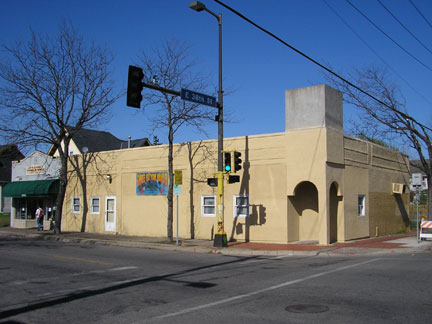
Dreamland building in 2013
DEL’S ORCHID CLUB
In May 1955 the building at 3755 Fourth Ave. So. became Del’s Orchid Club, O’Dell Livingston, proprietor. The Orchid Club was in trouble in 1957 for playing live music after 11 p.m. There had been numerous complaints about the place and a local minister called it a neighborhood nuisance. Its license was revoked in about May 1957 when bartender Robert Wallace was convicted of allowing the live music and fined $50.
BRIGG’S CAFE
Brigg’s Cafe was the third in a line of entertainment venues here. The change was announced in February 1958, but the Grand Opening was announced from July 18-19, 1958. Inez Clark was the new manager and the entertainment was Maurice Turner and Orchestra.
There were two Arcadia Ballrooms: One in Minneapolis, and one in St. Paul. Both were originally called Dreamland.
This one was located at 315 Fifth Street South in Minneapolis, across from the court house.
DREAMLAND
The building was built of brick and steel in 1909 for $30,000 as the Dreamland Dancing Pavilion. The building was 120 ft. by 165 ft. with a 28 ft. ceiling. It had a maple dance floor, with 18,600 square feet available for dancing.
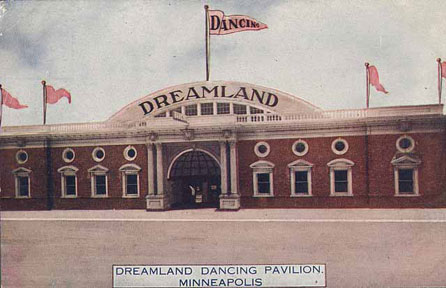
1911 Photo courtesy Minnesota Historical Society
DREAMLAND DANCES
Dreamland was known for its goofy themed dances; some revolved around the usual holidays, but others were the product of someone’s overactive imagination. Most, if not all, involved free giveaways for all. Here are some of them:
- Marathon two-step: men must wear gum boots
- Dance in the Hay, with “Farmyard sports” and giveaways of live chickens and ducks
- Billiken Dance: statuettes of the “God of Happiness” handed out
- Menagerie Dance, with trained elephant, lion, and cock fights?
- Waltz contest on elevated 14″ elevated plank
- Doll and Toy Party
- Post Card Dance
- Foolish Dance, with presents and stunts (April Fool’s Day, 1910)
- Nose Party (no explanation)
- Free Willow Plume (Easter related?)
- Wild West Party
- Motto Dance: All receive “witty and original framed mottoes”
- Novelty Dancing Contest
- Geographical Themes:
- Nights in China, Norway, Ireland, Japan, Germany, Florida
- Coney Island Night: Amusing horse race, novel pillow fight, free redhots
Signs of the times include cock fights and a “Colored Cake Walk” in 1910.
As early as January 1911, and perhaps earlier, the owner was identified as James C. Conway.
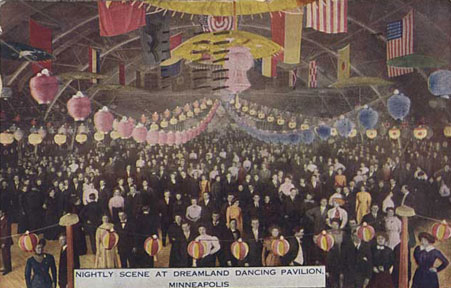
1915 Photo courtesy Minnesota Historical Society
Dreamland had problems with admitting underage patrons. Manager Joseph Nathan was found guilty twice in 1911 and 1912, and although he appealed his sentence as unconstitutional, at the last minute his attorney paid his two $100 fines, keeping him out of the workhouse.
In April 1912, W.M. Tobin was the Manager.
In October 1912, Dreamland began offering dance lessons before regular dances.
Dreamland came under new owners from Minneapolis, who instituted new policies: women were admitted for free, and for men, the cost of admission included dancing. This occurred on June 8, 1913.
ARCADIA ROLLER SKATING PALACE
On December 5, 1914, the building was opened for roller skating.
ARCADIA DANCING PALACE
Apparently roller skating wasn’t catching on, and the building reverted back to dancing or a combination of dancing and skating on April 10, 1915.
By the Fall of 1934 it was called the Aragon Ballroom, and remained so until at least New Year’s Eve 1935. The Aragon was more of a venue for the small Minneapolis black community, as evidenced by ads for dances in the Minneapolis Spokesman.
COURT HOUSE GARAGE
From August 1936 to 1945 the building was used as a public storage garage.
HERTZ
In July 1945 the building was purchased by the Hertz Driv-Ur-Self System for $50,000. Hertz used it for storage and servicing its cars. Hertz intended to construct a second story and connect them with ramps, but permit records do not indicate that this was done, and postwar building material restrictions probably made this plan unworkable. The building was purchased from Mrs. Alice Strass/Straus Landers of St. Paul/Pasadena.
The building was demolished in October 1961.
There were two Arcadia Dance Halls: One in Minneapolis and one in St. Paul. Both were originally called Dreamland.
This one was at 47 – 8th Street at Cedar in St. Paul.
DREAMLAND
The first date found in the Minneapolis papers that references the St. Paul site is September 4, 1911.
As with the Minneapolis site, the St. Paul Dreamland became the Arcadia Roller Skating Rink in 1915. However, it apparently didn’t stick, or just went back and forth as roller skating and dancing. At its opening, the rink was managed by John F. Davidson
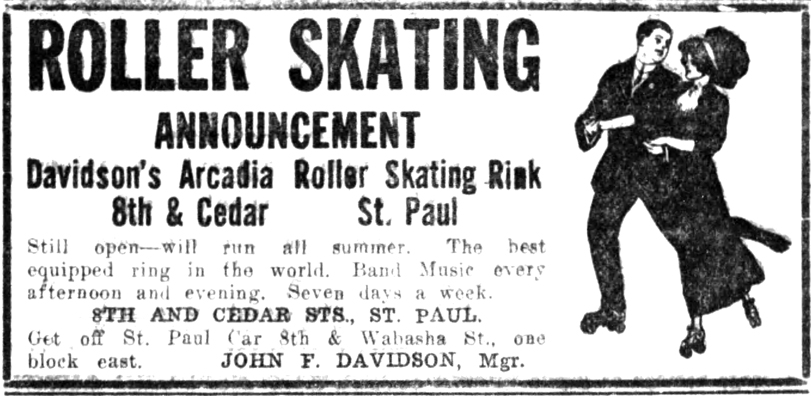
April 13, 1915
An item in April 1918 mentioned a brou-ha-ha at Dreamland when the soldiers at Fort Snelling got paid and got a hold of some illegal liquor and got into a fight.
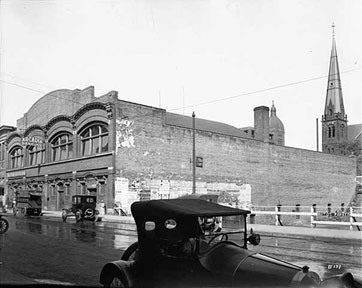
1922 Photo courtesy Minnesota Historical Society
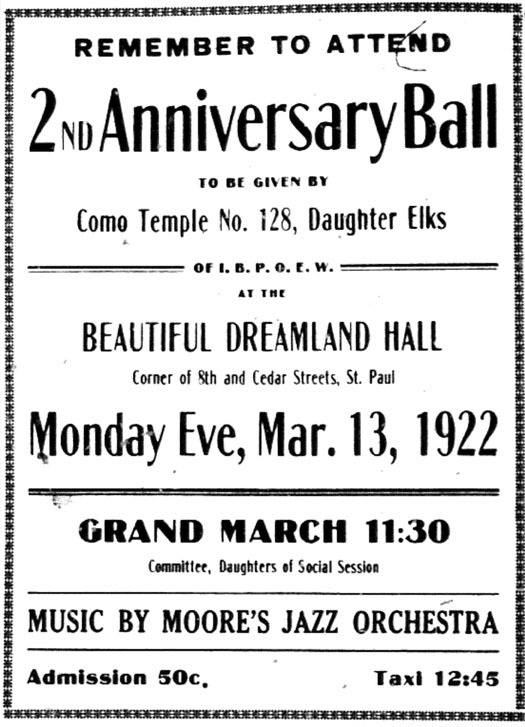
Northwest Bulletin
In 1931 there was a Dreamland Golf Course at 8th and Cedar – Mark Youngblood found an ad in the Humboldt High School yearbook!
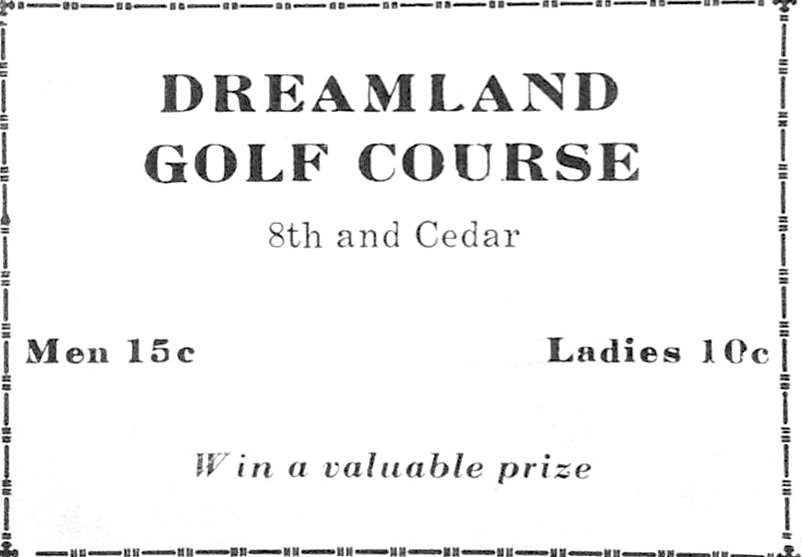
Talk about Twin Cities teen culture wouldn’t be complete without the drive-in restaurants that were everywhere in the Cities in the ’50s and ’60s. This page concerns those in and around St. Louis Park. If you have any additions or corrections, please contact me!
ST. LOUIS PARK
On Excelsior Blvd. there have been drive-ins going back to the 1920s. During the early 1950s, more were added in proximity to the High School, which was in the Central building on Highway 7 and Wooddale.
- The State’s first Dairy Queen was at Highway 100 and Excelsior Blvd. – 1947-66
- The Dari-Wipt/Meal in a Bun (also called Carlson’s Drive-In) was next to the Dairy Queen at Highway 100 and Excelsior Blvd., 1949-66
- Next to the Meal in a Bun, at least in 1963, was a place called the Red Rooster. See a blurry photo of it here.
- A series of drive-ins dating back to the 1920s at 4700 Excelsior Blvd.
- Dairy Way/Cliff’s Drive-In/Jack Reed’s was at 5408 Minnetonka Blvd. – 1952-71
- Dairy Mor – 3 locations
- Dutch Mill Dairy Bar (“Ron”), no address given in 1950 ad in Echo. Served sundaes, malts, drum sticks, sandwiches, and pop.
- The Tee Off Drive-Inn was apparently associated with Park Putt Miniature Golf, 4701 Highway 7 (at Natchez) in 1951.
- S & K Drive-In – 1956
- Park Drive-In – 1960
- The Dari VI was at 6210 W. 36th Street, across from St. Louis Park High School (Central). It was an ice cream and BBQ beef place run by Vincent Ryan. It’s not in the yellow pages, but Ryan, who lived at 6017 W. 35th Street, is listed as the owner of the Dairy VI in the residential section. There are ads for it in the Echo in September 1953, June 1954, September 1955, and June 1956. All vestiges of this place are gone. The photo below is not it, but it was something like this. Mark Lapakko tells us: “The Dari VI was moved to Isle, Minnesota (Mille Lacs Lake) where it is still in operation today. It has been expanded and remodeled several times. It is still called Dari VI.” Thanks, Mark!
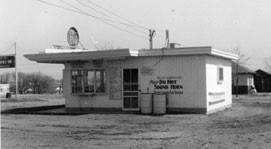
- The Oak Hill Drive Inn (later Wagners, now Galaxy) – 1952
- Cliff’s/Jack Reed’s Drive-In was on Minnetonka Blvd. just west of Highway 100.
- And, of course, the State’s second McDonald’s was built across the street from the new High School in 1958.
THE PYLON
In 1949, North Side St. Louis Park brothers Albert and John Yngve and their friend Bill Nordstrom built the Pylon Drive-In at 6224 Wayzata Blvd. in Golden Valley. The Ynvge family grew on the south side of Wayzata Blvd. (Highway 12, now I394) on land that is now 6311 Wayzata Blvd. in St. Louis Park. When they opened for the season they did it up right, with DJ Sandy Singer coming out to do a remote broadcast, searchlights, etc. The first ad in the Echo was on May 23, 1950.
One of the features of the Pylon is that it played rock ‘n’ roll. Al Yngve recalls that the carhops (all the staff was from SLP) would bring in their 45s, starting in about 1955 with “(We’re Gonna) Rock Around the Clock,” which played over and over again! The young owners were very protective of their carhops, taking them home at night themselves. By 1957 the Yngves were in into their law careers and they rented out the Pylon for a couple of years. They built a building on the site, where Al Yngve had his law practice and later a travel agency.
The ad below is from the Echo on September 16, 1952.
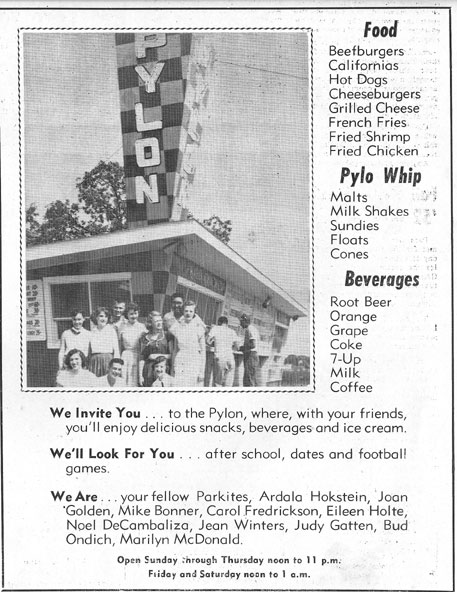
The ad below is from the Echo on September 8, 1953.
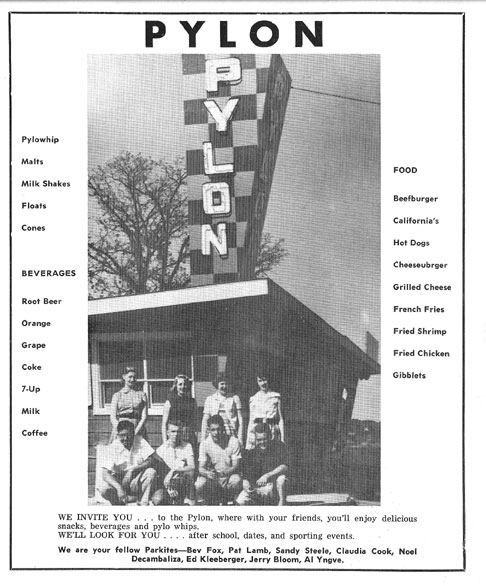
THE EDINA DAIRY-MOR/BILTMORE DRIVE-IN
In 1952 there was a Dairy-Mor, presumably owned by the Rodbergs, at 5001 Vernon Ave. at Interlachen. By 1959 it was the Biltmore Drive-In, owned by Lester Ericson. The photo below is courtesy of the Edina Historical Society.
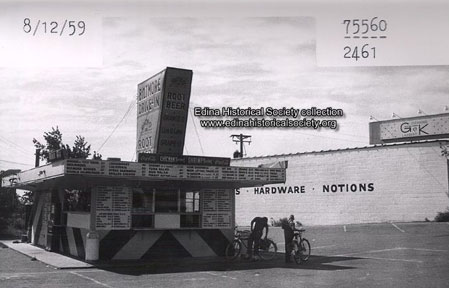
DRIVE-IN-POINT
Heading east on Excelsior Blvd. from St. Louis Park into Minneapolis was something called Drive-In-Point, where the Calhoun Commons Shopping Center is now (built in 1999). This is about where Lake Street and Excelsior Blvd. diverge. Please contact me if you have any information on the drive-ins of Drive-In-Point.
3080 EXCELSIOR BLVD.
DRIVE-THRU
Perhaps the first, open the summer of 1953, was a place just called Drive-Thru, advertised in June as “nothing like it in all the suburbs,” even though it was really in Minneapolis. There was an ad for it in the St. Louis Park Echo in October 1953:
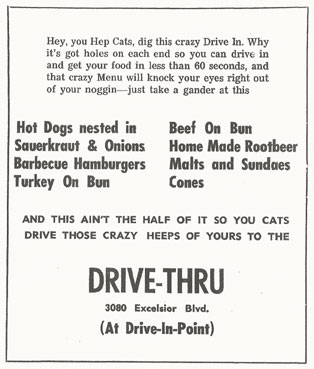
TED’S CAR-A-TERIA
By June 1954 the site had been renamed Ted’s Car-A-Teria, and featured Kosher hot dogs with Kraut, Double Decker Hamburgers, malts and root beer, with the Quickest Service Anywhere.
DAIRY-MOR
By July 1959, 3080 Excelsior Blvd. was a Dairy-Mor Drive-In.
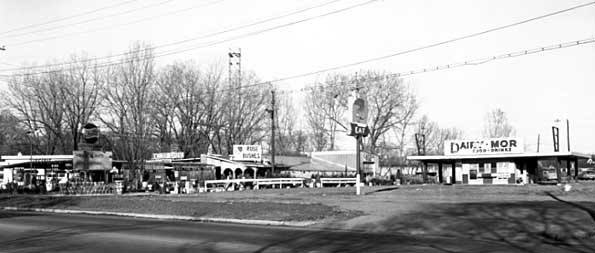
1963 photo courtesy Minnesota Historical Society
3080 Excelsior Blvd. is now part of the Calhoun Commons Shopping Center.
3019 W. LAKE STREET
CALHOUN DRIVE-IN
The Calhoun Drive-In was described as “Ultra New” in want ads starting in August of 1956. Listings ended in January 1965. According to today’s map, this would have been right inside the point.
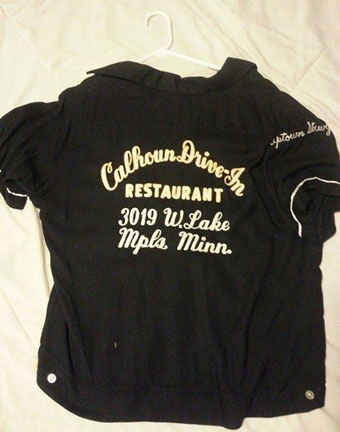
This very cool shirt was posted on Facebook by Steven Mead.
Photos below are of the Calhoun Drive-In, 1956, courtesy Minnesota Historical Society.
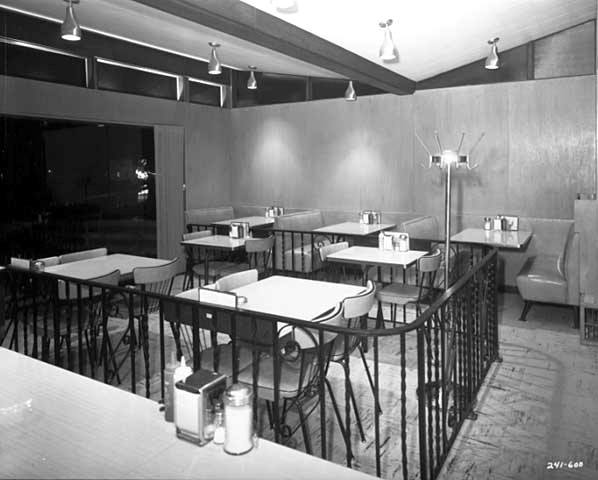
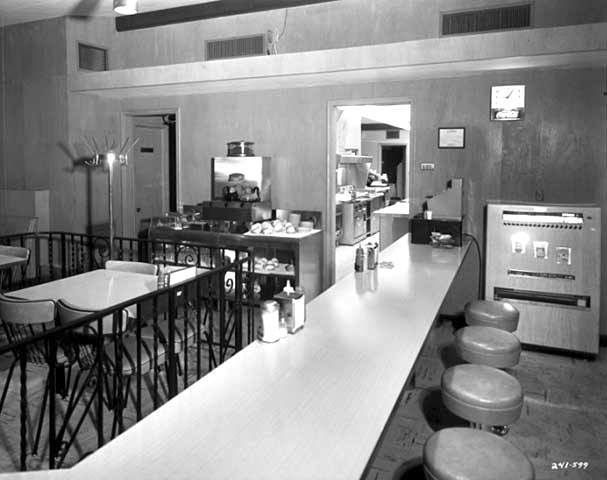
The building here now was built in 1966.
3025 W. LAKE STREET
This location hosted a succession of drive-ins and restaurants. The building was originally 22 x 28, and built in June 1947.
FLASH DRIVE-IN
August 1947 to May 1950
PAPPY’S DRIVE-IN AKA POOP DECK PAPPY’S DRIVE-IN
In May 1950, a 12 x 22 x 8 addition was built.
May 1950 to September 1953; owned by Bert Buttles and Orville Dahl
TERRY’S DRIVE-IN
Max Altman bought in 1956 or 1957.
In 1959, Altman spent $45,000 remodeling the place. He had a 138 x 40 x 11 concrete block air-conditioned cafe built and it became
TERRY’S LAKEMOOR DRIVE-IN
until December 1963
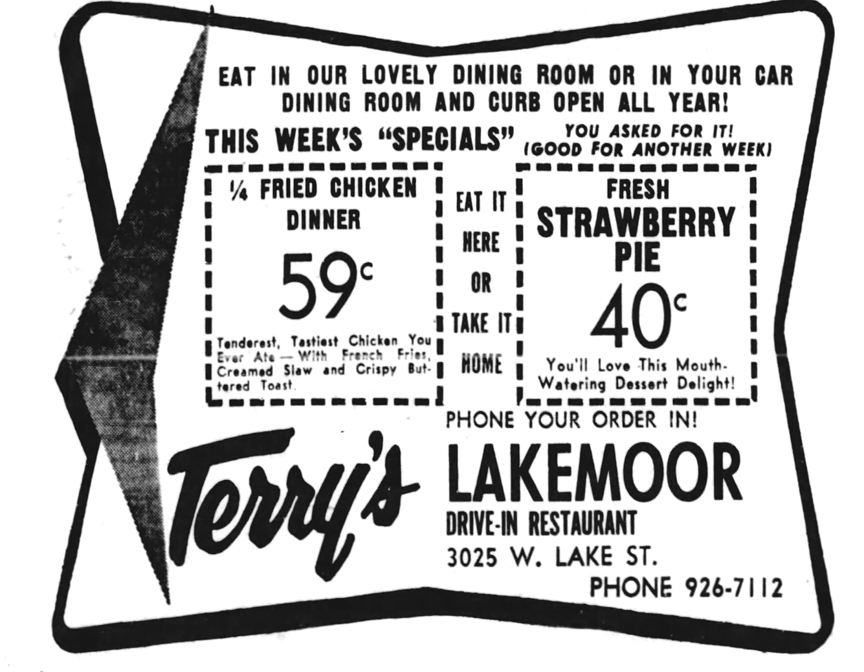
Star Tribune, February 9, 1963
MAXIMILIAN’S
March 1964 to February 1969
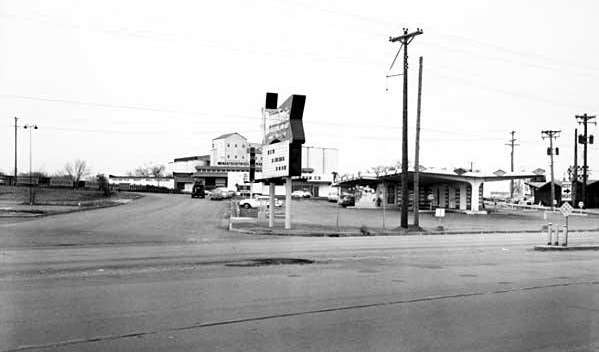
Maximilian’s, 1964 – courtesy Minnesota Historical Society
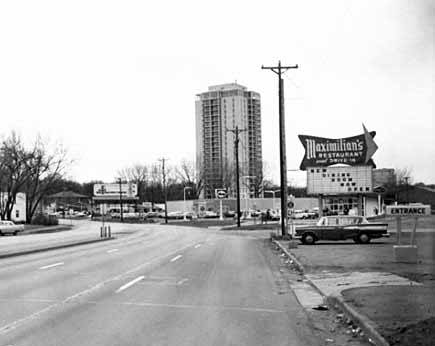
March 1964 Photo courtesy Minnesota Historical Society via Alan Freed
In January 1967, $14,000 was spent on a 36 x 42 x 12 addition (not counting the cost of air conditioning).
ALTMAN’S
February to June, 1969
THE BIG STEER
July 1969 to January 1971
ALTMAN’S (Again)
April 1971 to November 1976
THE RESTAURANT
December 1976 to September 3, 1991 . For the last 3-4 years it was owned by Bob Rabe.
Minneapolis Star Food Critic Karin Winegar stopped into The Restaurant in 1979. It appeared that half the building was the Restaurant, and the other end was a place called the Martinis and Bagels pub. The place always had two addresses (3025-3027), and there had been several additions, so it’s entirely possible. Winegar doesn’t always get her facts right, but she does give us a good description of the place in 1979.
The Restaurant manages to be cozy despite the Formica tabletops, Naugahyde booths, Muzak and plastic paneling. It’s a warmly informal place that, if located in the suburbs, would draw primarily a family clientele.’The only surprise on the Restaurant’s menu is the menu itself – it’s a cylindrical hanging lampshade counterweighted by a bottle of gravel. (Minneapolis Star, February 9, 1979)
This site is now Fire Station 22, built in 1992.
3118 WEST LAKE STREET
PULVER’S
Places listed at this address in the Minneapolis newspapers included a beach cottage, a Pure Oil station, West Lake Outboard Motor Sales, and Jerry’s Pure Oil Service and Outboard Sales. It was also the home of Mrs. Harriet Pulver, who died on April 27, 1949.
In 1950, a news article named Don DeLaria the owner of a Drive-In at Lake Street and Excelsior Blvd., and gave his address at 3112 W. Lake Street.
Apparently one of her survivors decided to turn the land into a drive-in, and it became Pulver’s in about May of 1952. For that “In Between Snack” “Pulover to Pulvers. Root beer, giant hamburgers, Ice Cream.” They were still there in September 1953, advertising hamburgers, French fries, and malts.
It appears that Pulver’s closed in May 1960, and the property was put up for for sale in July 1960.
PUTT-PUTT GOLF COURSE
In May 1961, the area’s first miniature golf course was installed on the property.
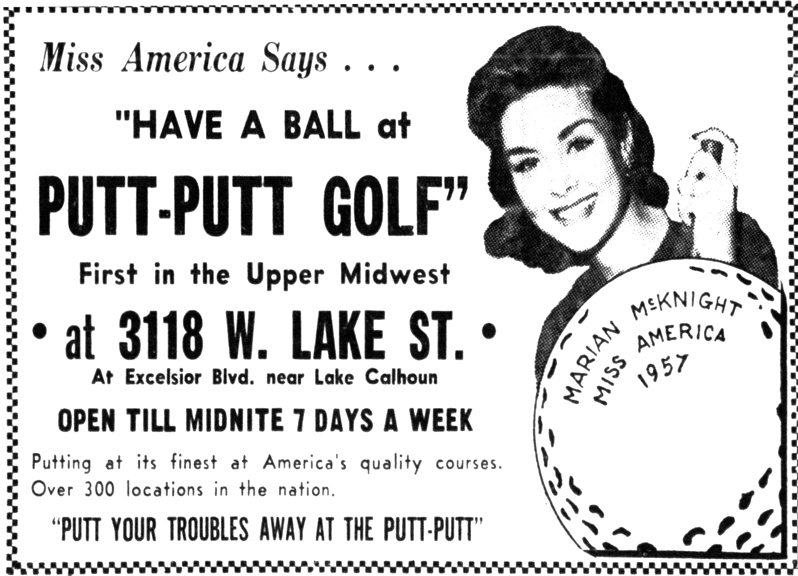
May 26, 1961
THE TRUELSONS AND PORKY’S – 1960
A search for Roy W. Truelson finds that he worked 17 years for the Army Corps of Engineers before becoming involved with restaurants and putt-putt courses.
Roy’s son Raymond Truelson worked at a root beer stand/grocery store/the Adobe Drive-in at 3544 Cedar Ave. starting in 1946 according to his obituary.
In May 1950, Raymond and Warren Nelson were the owners of the Flat Top Drive In, located at 4604 East Lake Street. Ads for the place stopped in May 1963 when it became associated with a brutal murder.
Roy and Raymond opened their first Porky’s in 1950 at 5751 Lyndale Ave. So.
In 1953 they expanded to 1890 University in St. Paul.
In 1957 they expanded to 2107 East Lake Street at Hiawatha Ave. This site was converted to Nora’s in 1975, named after son Raymond’s wife.
The fourth and last Porky’s opened at 3118 West Lake Street in 1960, according to Roy’s obituary. This location was just north of Lake Street from Drive-In-Point. County records showed that the building was built in 1957. A 1962 ad says that it was open all winter.
The signature item on the menu was a hamburger with an onion ring plopped on top of the bun.
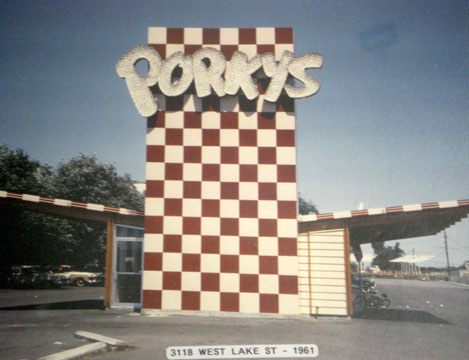
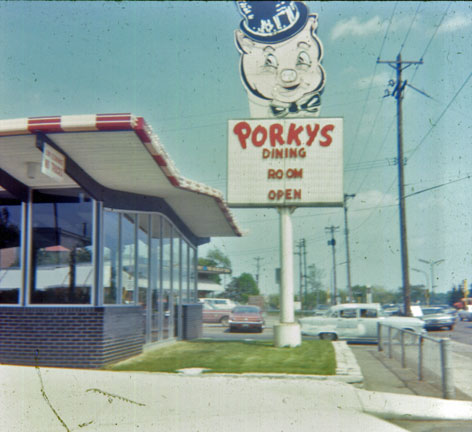
Lake Calhoun Porky’s photo courtesy Susan Shallman Anderson
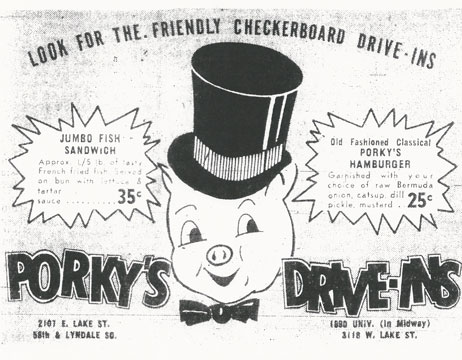
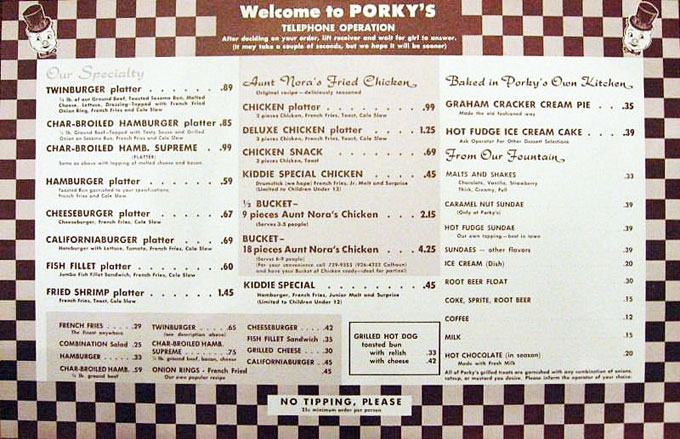
Porky’s closed this location in about April of 1978.
Roy Truelson died on March 30, 1986.
WALDO’S PIZZA JOYNT
From about October 1979 to 1985, Waldo’s Pizza Joynt was at this location:
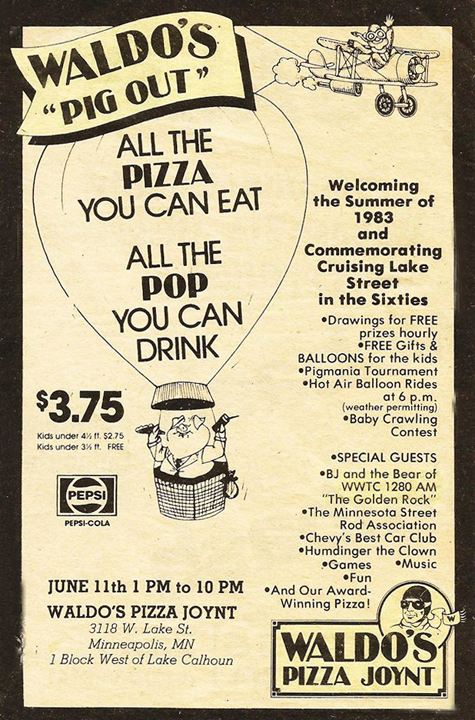
1983 ad courtesy Jeff Lonto
NORA’s
The next iteration was Nora’s, named after Ray Truelson’s wife. (Word on Facebook is that “Nora began at Porky’s as a carhop in 1957. She became Ray’s girlfriend and eventually his wife and business partner until Ray died in 1994. Ray’s children were Ray,Jr., Roy, Nels, Thorstein, Trygve, and Joli.* They went to Washburn High School in the late 60s and early 70s.”) The Porky’s on Lake and Hiawatha had already been renamed Nora’s.
Food critic Jeremy Iggers liked Nora’s, saying it catered to and older crowd and served solid food. But in July 2001 he made a return visit and found that the place had been updated, trying to draw a younger crowd. He wasn’t happy, and very unhappy with the food, giving it on one and a half stars. Nora’s closed on October 27, 2003.
*Joli’s body was found in Minnehaha Creek on July 3, 1972, after she had accepted a ride from a stranger while hitchhiking. She died of a blunt force blow to her head. She was 16.
Raymond Truelson, Sr. died in September 1994.
TRYG’S
A restaurant called Tryg’s was built on the spot in 2005, owned by Ray Truelson, Jr. It closed on January 31, 2015. It was replaced by a 164-unit apartment building.
TREASURE FREEZE
The photo below, dated November 8, 1952, is merely described as being at Lake Street and Excelsior Blvd. by the Minnesota Historical Society. Thanks, Nancy Pearson!
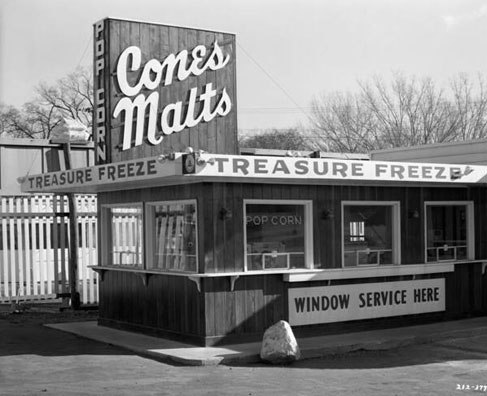
Not here, but around. This ad is from 1963.
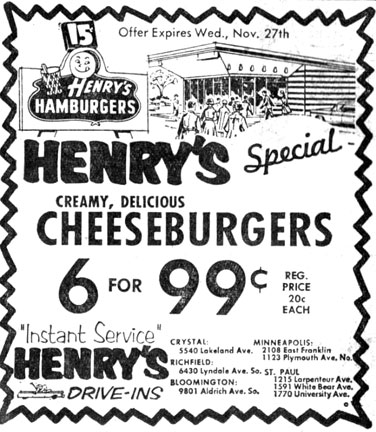
In the 1950s, businessmen in the restaurant industry were attempting to mimic the success of McDonald’s, and thus you had establishments such as Henry’s.
Henry’s was a major player in the 50s, 60s, and 70s: By the early 60s there were over 200 of them—more than McDonald’s had at the time.
Failure to adapt to the industry’s changes, competition from other fast-food burger chains, and a controversy involving the use of horse meat are all cited as potential factors of the chain’s rapid downfall.
Only one Henry’s, in Benton Harbor, Michigan, remains.
Save
This venue was located at 444 Wabasha Street in St. Paul.
The Proprietor in 1944 was Al Coleman.
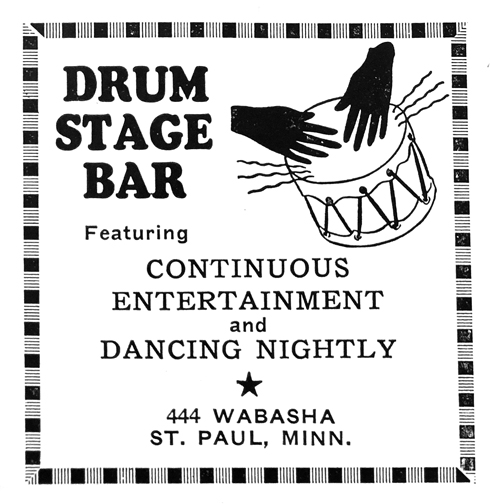
Image from State Fair Program, 1948, courtesy David Black
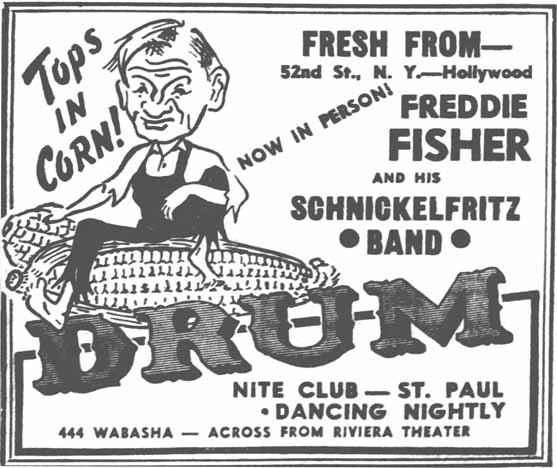
October 13, 1948
Sometime in 1949, the proprietor became William Steinman, according to The Musician.
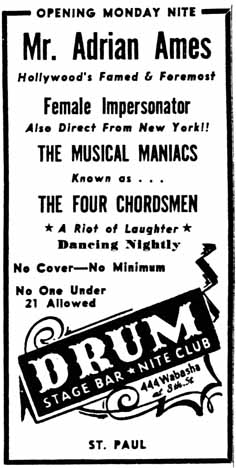
August 28, 1949
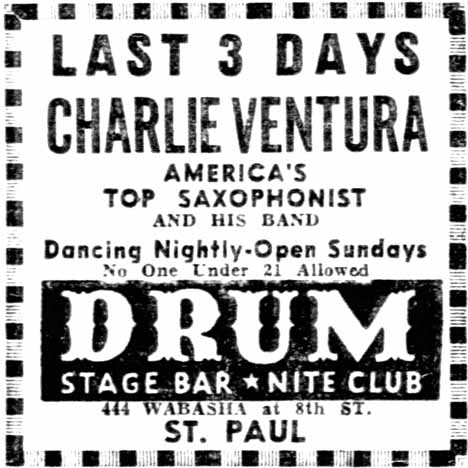
October 29, 1949
DRAG SHOWS END THE DRUM
The Female Impersonator show was apparently popular enough to bring back, and had been running for eight days before the police had had enough and shut it down on November 8, 1949. Church and civic leaders had objected to “improper songs and the nature of the act.” (Minneapolis Star, November 9, 1949) What were Church and civic leaders doing at the Drum Bar, anyway?
Sometime before May 1950, the Drum’s location became the new spot for Heinie’s, which was then renamed Alary’s. Confused? Join the club.
Music ain’t linear. Especially in St. Paul.
Please see The Park Terrace.
This page covers the venues located at 2601 – 26th Ave. So., at the notorious “Hub of Hell” in South Minneapolis:
- Heinie’s Bar
- Duffy’s Bar
- Norma Jean’s
THE BUILDING
According to the City’s building permit cards, the building was erected in 1886. The original footprint was 12′ by 22′.
EXCHANGE HOTEL
The building was originally the Exchange Hotel and saloon, and in the early days it was owned by George E. Thompson II. Thompson was born in West Union, Iowa, on December 25, 1859. He worked for the railroad for several years before moving to Minneapolis, where he owned the Bar. He died from pneumonia at the age of 46 on May 8, 1906. His wife, Louise, ran the hotel and saloon for a while but eventually lost it and moved in with one of their sons.
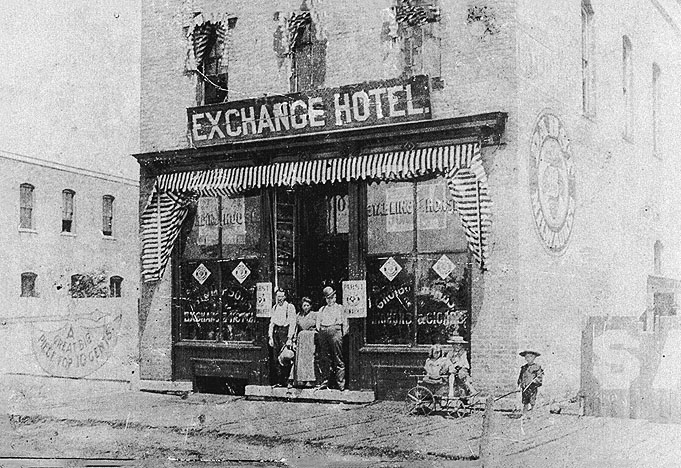
Exchange Hotel with Thompson family. Photo has no date and no provenance.
John Gallinaugh had a liquor license at this address as far back as May 1, 1899 to 1903. Permit notes call it a saloon through 1904.
In 1905 to 1914 it may have been a store.
In 1921 there was a 16′ by 20′ addition – perhaps the second floor.
In 1927, during Prohibition, Fred R. Coyle ran a restaurant.
The place got its liquor license shortly after Prohibition was over, in January 1934. The owners were Henry C. Reeves and F.W. Meissner. That year there was a significant addition measuring 66′ by 26′.
HEINIES’S BAR
There were a couple of Heinie’s bars – the other was in St. Paul. We find one listed at this address in May 1950.
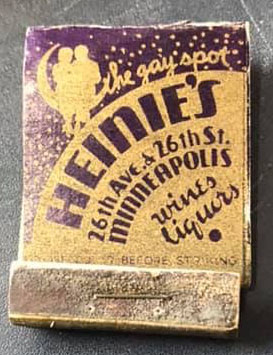
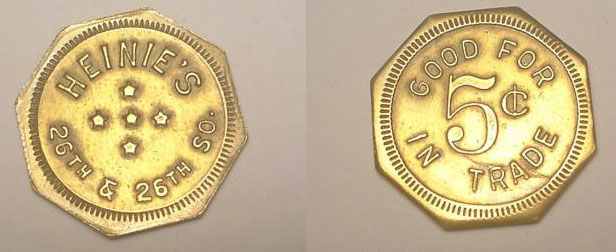
In February 1953, an article reported that $90,000 was paid for Heinie’s Bar, although it didn’t say which one.
DUFFY’S BAR
It opened as Duffy’s Bar in 1953. Presumably the liquor license was transferred to Raymond T. Duffy and his brother Joseph, who also purchased the property.
Early entertainers included quality jazz orchestras, notably the Ray Komischke Quintet.
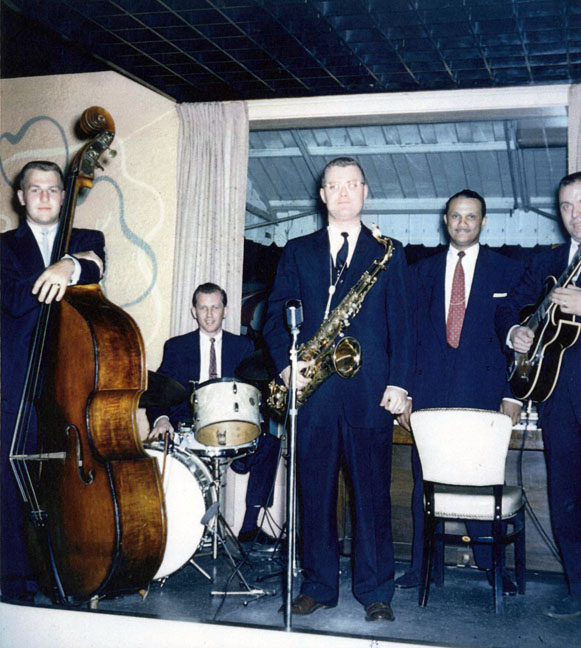
Ray Komischke Quintet at Duffy’s, @1956-58: Jim Hughart, Russ Moore, Ray Komischke, Rufus Webster (Piano), and Bob Caldwell. From the archives of the St. Paul Musicians Union, Minnesota Historical Society
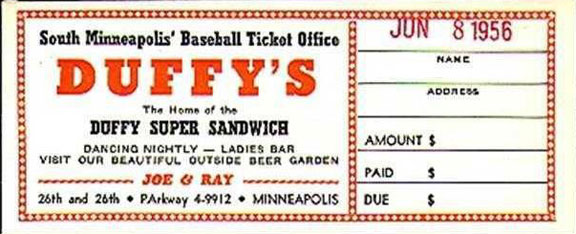
TRANSFER TO GEORGE FOSTER
On June 10, 1960, the liquor license was transferred to George C. Foster and the building and fixtures were sold to him for $250,000. I would love to know the reason for this, as I found no evidence that the Duffys lost their license. It is also curious that Foster kept the Duffy’s name.
RECONSTRUCTION
Permit cards show that a $150,000 building and alteration job was done on the building at the end of 1960/beginning of 1961, with Reco Construction Co. as the contractor. These wonderful promotional pages were posted to Facebook by Sydney Milan. They show the state of the art night club, 1961 style.
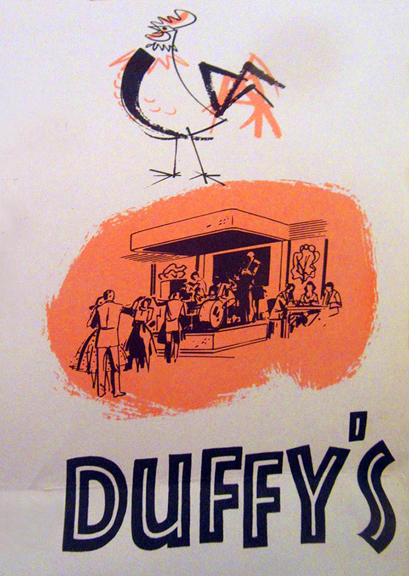
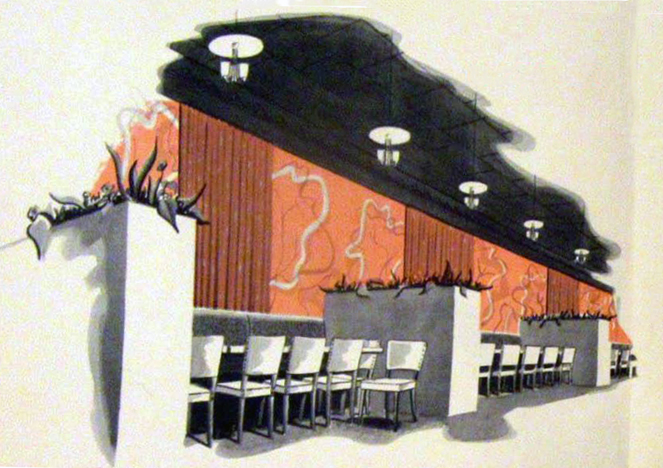
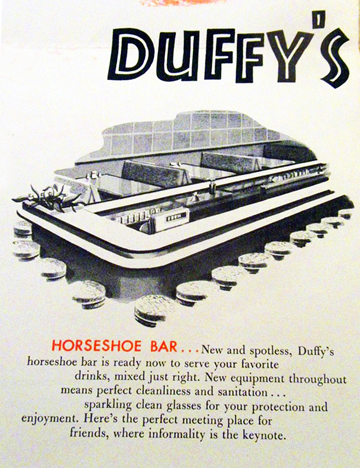
Horseshoe Bar
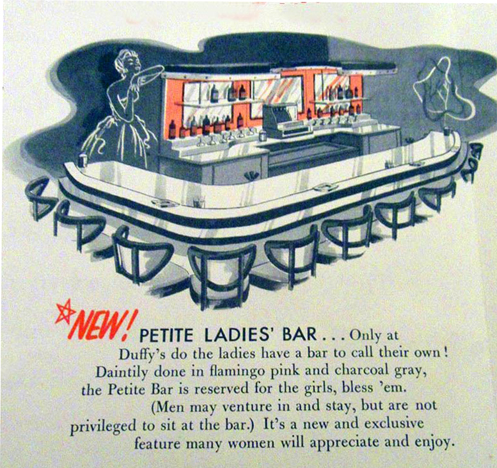
Petite Ladies’ Bar
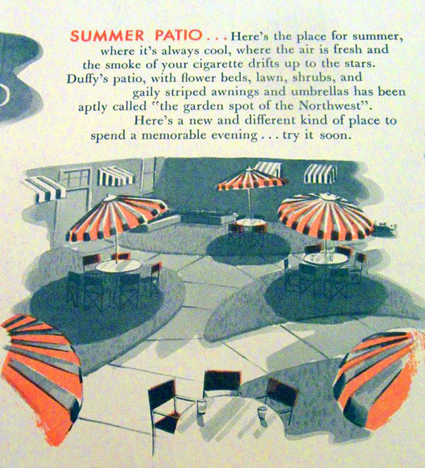
Summer Patio
THE SATELLITE ROOM
1961 was all about the space race, and Duffy’s was all over it. The open courtyard that had been Heinie’s beer garden was closed in with a “spectacular plastic domed Satellite Room.” The bandstand, now in the center of the dance floor because of the conversion of the beer garden, was made to revolve to accommodate the dancers on all sides.
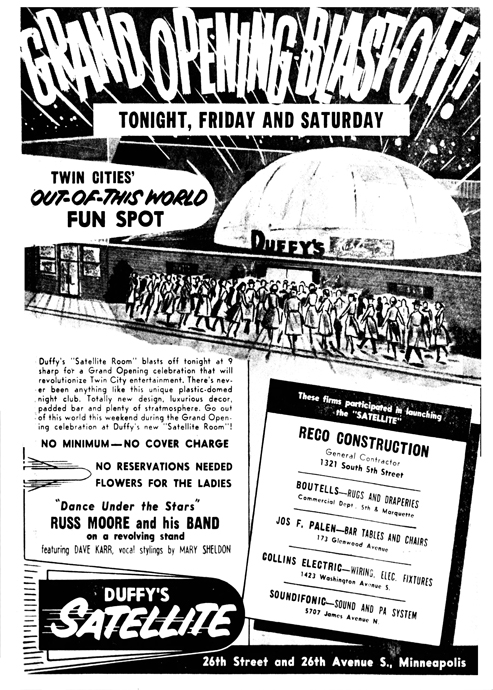
Minneapolis Star, February 9, 1961
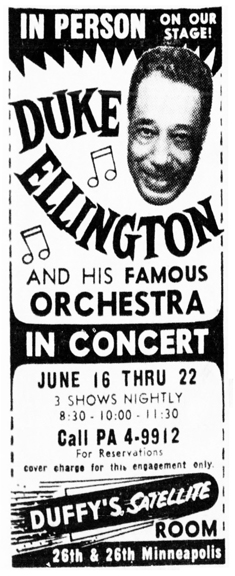
Minneapolis Tribune, June 1961

1961
An ad in the Minneapolis Daily Herald from July 1962 advertised the Dave Kerr Quartet for Dancing, and a Twist-Limbo Contest, Monday through Thursday. There was also a talent show on Thursdays.
AUGIE AND THE TWIST
The Augie Garcia Quintet was “Packing ’em in” in September 1962. George C. Foster was “Your Host.” 1962 was the year of the Twist – the ad below from November 1962 shows that Augie’s band included Ellen as their “Twist Girl!” Other members of the band were:
- Augie on guitar
- Don Rustad on Sax and Vibes
- Art Resnick on organ
- Jesse Lopez on drums
- Shari Ferris, “Songstress”
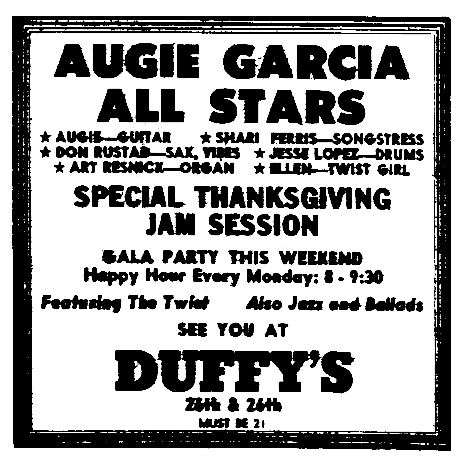
Minnesota Daily, November 21, 1962. Ad courtesy Robb Henry
In his October 1, 1961, column in the Minneapolis Tribune, Will Jones described the scene:
At Duffy’s the theme is chaos. In the front bar, Al Braley, in derby hat, looking like one of the Foy brothers, leads old-style sing-along tunes. In the two dance rooms, Augie Garcia and quintet make conversation impossible in both simultaneously, thanks to the revolving stage in the wall between the rooms.
The Duffy’s regulars seem to favor the older of the rooms, and the action there starts early. The newer room, topped with a monster of a plastic bubble in the center, fills up later with the overflow, and in the later hours of a weekend night both dance floors are jampacked. So is all the standing and sitting space beyond.
Garcia started out his engagement there with a piano as part of his instrumentation, but the piano player complained his fingers were getting sore and bloody from trying to make himself heard. An organ was substituted for the piano, and there’s no trouble hearing that at all.
A June 1963 ad said you could dance to an orchestra nightly, but you could also twist with house band Terry and the Pirates in the Satellite Room. It appears that the plastic roof idea didn’t exactly work out, though. The permit card has an entry dated October 1963 for installing “roof over dome” at a cost of $3,000.
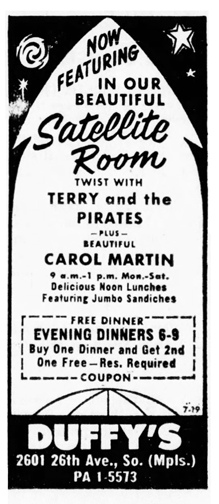
Minneapolis Tribune, July 1963
BACK TO THE DUFFY FAMILY
An article dated March 24, 1964, in the Star says that George Foster’s liquor license was revoked last February when he was convicted of selling liquor to a minor. The license was transferred back to Raymond T. Duffy. His brother, Joseph, would continue to run Duff’s downtown on his own.
On April 1, 1964, the Tribune announced, “Ray Duffy is back on the corner … 26th and 26th South that is, playing the role of friendly host again… We invite you to have fun … and frolic! Pleasing beverages … pleasing prices … Entertainment and dancing nightly.”
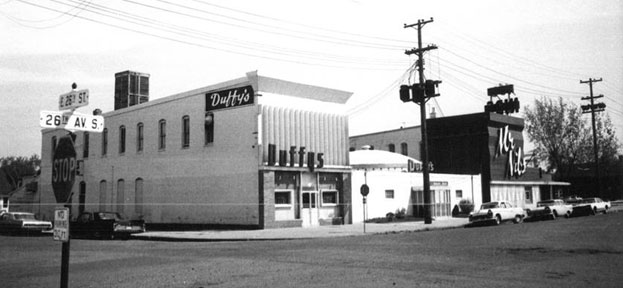
Duffy’s and Mr. Nib’s, 1965. Photo courtesy Minnesota Historical Society
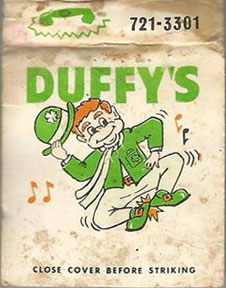
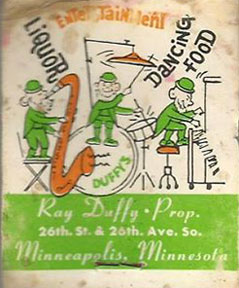
The above matchbook, posted by Justin Wood, is a little worse for wear, but love that band! Mike Duffy, Ray Duffy’s son, created the leprechaun character!
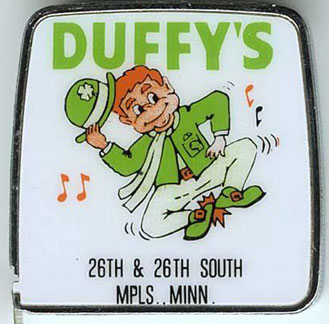
This Duffy’s keepsake is a tape measure!
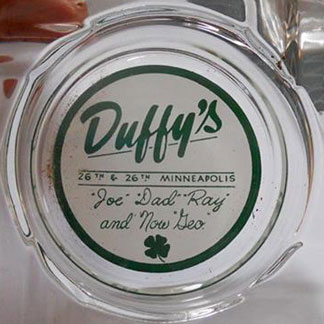
Ashtray from the collection of Mark Youngblood.
In 1975, Duffy’s underwent some sort of rehab, including a fresh coat of paint, presumably. I can’t guarantee that it was exactly this shade of green…
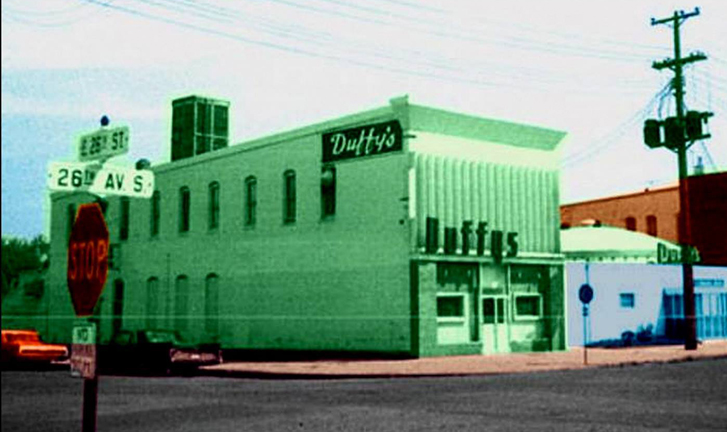
On May 26, 1976, policeman Michael Patridge, 24, was killed by gunfire at Duffy’s while working off duty after an argument.
NEW OWNERSHIP, NEW MUSIC
In July 1979, Dan and Lesley Simon-Johnson of St. Paul took over Duffy’s. The July 11, 1979, Minnesota Daily announced that Duffy’s was trashing its disco records and going Rock ‘N Roll. Although it had been around for ages, it was advertised as “Twin Cities Newest Club.” Preview week was July 12, 13, and 14. Not exactly a week, but…
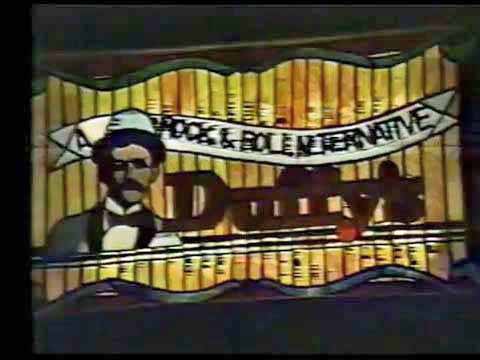
In January 1980, Dan and Lesley were given citations for running a disorderly house when two male dancers and four female patrons were arrested for disorderly conduct on Ladies’ Night. Apparently a newspaper article had described how the dancers’ G-strings routinely did not stay in place, and that the women were touching that which was illegal to touch. Two undercover policewomen were sent in and made the pinch, so to speak.
NORMA JEAN’S
In June 1984 the building was painted pink (from its traditional green) and dubbed Norma Jean’s. Again, this may be pinker than the building really was …
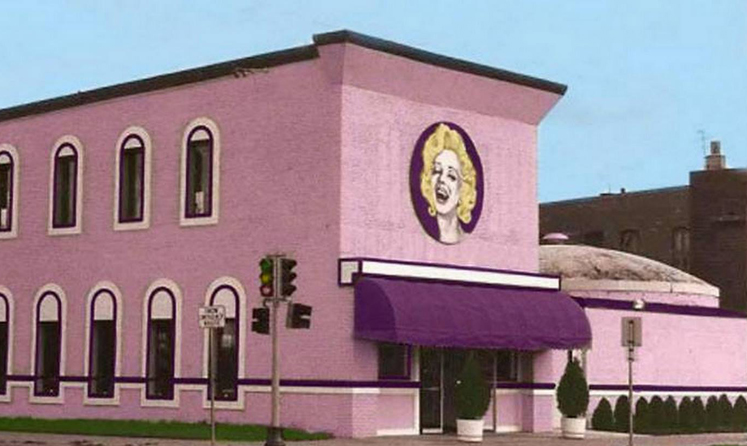
The music at Norma Jean’s was diverse and changed frequently, but by 1991 the club was accused of attracting trouble to the area with its teen nights and black clientele that included gangs. In May 1991, a young man was shot and killed in the crossfire of two gangs that had been in Norma Jeans. The man had come out of the Mirage nightclub nearby and was an innocent bystander.
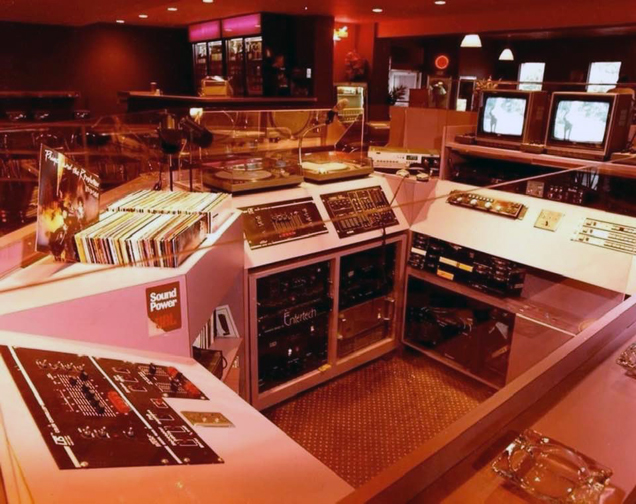
DJ Console at Norma Jean’s. Photo credit Dean Vaccaro, courtesy Dan Johnson
BANKRUPTCY
On December 31, 1991, Norma Jean’s abruptly closed, and owner Leslee Simon filed for Chapter 11 bankruptcy citing $600,000 in debts. Raymond T. Duffy still owned the property, and Simon had been making contract for deed payments to him for 12 years.
The nightclub had been at the center of frequent fights and shootings, prompting complaints from neighbors and surrounding businesses. They said the club’s dance parties and “urban funk” format attracted unruly patrons who became violent.
In late October 1991, more than 25 area residents showed up when the City Council’s Public Safety and Regulatory Services Committee was scheduled to review Norma Jean’s license. The meeting was canceled because Simon’s attorney, Mark Gehan, had reached an agreement that morning with an assistant city attorney.
Gehan said at the time that Norma Jean’s would be open only for Friday night reggae concerts and for special events such as wedding receptions. Since then it has rarely been open..
Gehan said accusations that the dance parties at Norma Jean’s generated violence were racist. His letter to the city said, “It has been alleged that the Urban Funk Format prompted disorder and violence in the neighborhood. The essence of that accusation is that the black persons who favor the music are troublemakers. We disagree with that and deny it. If there were racial tensions in the vicinity of 26th and 26th, it is unfair for anyone to assert that the originate with one racial group rather than another.”
(Tony Kennedy, Minneapolis Star Tribune, December 21, 1991)
A February 1992 article stated that the owners of Norma Jean’s planned to reopen the club after renovations were made, including installing a stage for live performances. Owner Leslee Simon hoped to head off foreclosure proceedings, which were scheduled to begin in court the following week. Funk Night would not return as part of the format. City Council member Tony Scallon noted that police calls had dropped to zero in the area since the club closed the preceding October. (Jill Hodges, Minneapolis Star Tribune, February 19, 1992)
There is no evidence that Norma Jean’s opened again.
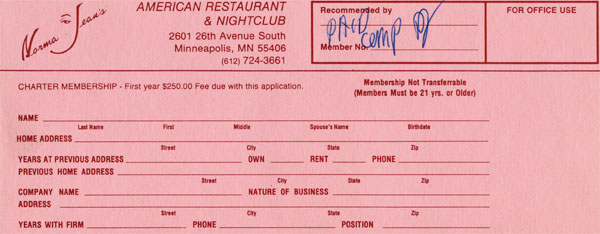
My Mother-in-law had this!
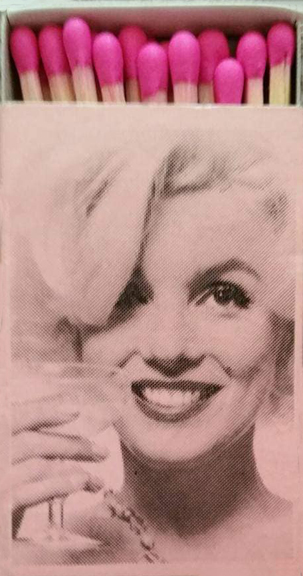
Matchbook images courtesy Jeff Mclaughlin.
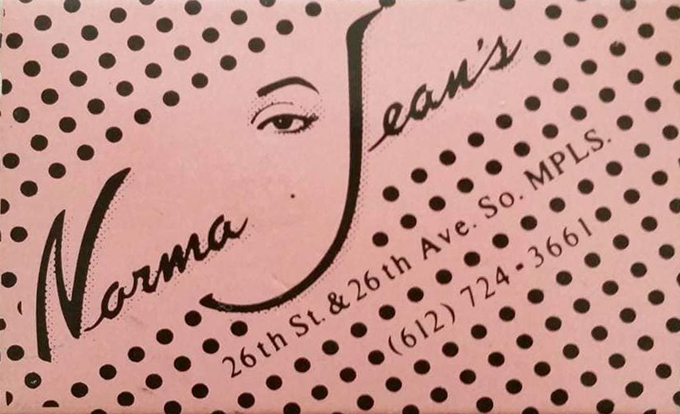
Jon Bream reported that the building burned on Saturday, October 25, 1997. He also said that the City had purchased it, that it had stood empty since 1991, and that it had been scheduled for demolition. Apparently this wasn’t big enough news on its own. (Minneapolis Star Tribune, October 28, 1997)
The building was demolished on November 3, 1997, and was rebuilt as an addition to the New French Bakery.
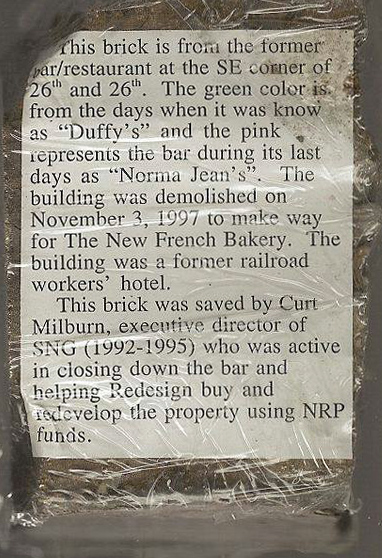
Found on Facebook!
The Dug Out was at 206 So. Third St., Minneapolis, 1953. Not really sure if it was a music venue.
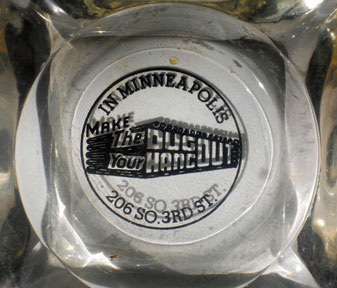
From the collection of Mark Youngblood.
Save
Save
Dyckman Hotel, 6th and Hennepin.
- Entertainer Auzie Dial performed in the Robin Hood Room in 1946.
- The Chateau de Paris hosted barrelhouse piano player Meade Lux Lewis in 1963.
- The Fox and Hounds Lounge featured nightly entertainment in 1969.
The hotel was demolished in November 1979. Click on the link above for James Lileks’ site with history and photos.
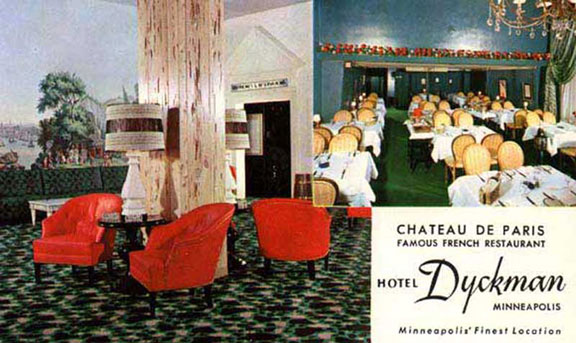
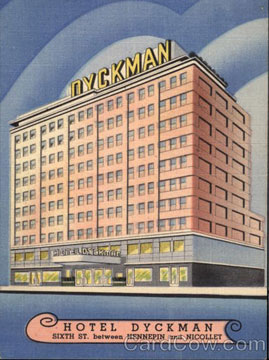
The Eagan Safari Club (not to be confused with the Safari Club in Mendota Heights) was located at 2705 Highway 55 in Eagan Township.
A March 20, 1966 article in the St. Paul Pioneer Press said that it could hold as many as 600 teenagers, according to Robert Cargill, a member of the Franchise Investment Corp. “We hope to expand with another club but we’re waiting for the right place to come along.”
Maple Grove
574 Wabasha at Summit, St. Paul, 1926-35.
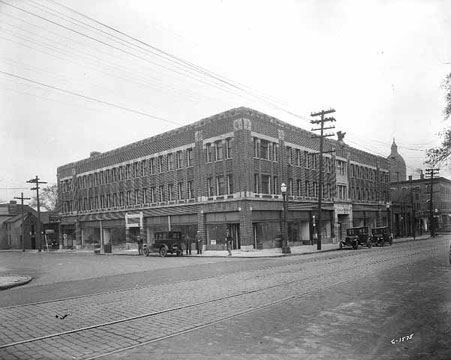
Eagles Hall, St. Paul, 1926 – Minnesota Historical Society.
Cedar Ave., 4 miles south of the Minnesota River in Rosemount. Arthur J. Eaton was the owner of the Roller Garden in St. Louis Park from 1939 to 1957.
The Ebony Lounge was actually the second floor of Road Buddy’s Bar-B-Q at 799 University Ave. in St. Paul. Please click that link to read its history.
Eddie and Freddie’s Place was a tavern located at 4230 Wayzata Blvd., next to Bill’s Place in 1939.
It was there until at least March 1947, at the Dan Patch Crossing.
It’s not certain whether it had music, but Bill’s Place next door did, and one would think that to compete, Eddie and Freddie would offer entertainment as well.

Eddie and Freddie’s – on the left, 1939. Photo courtesy Hennepin County Library
Eddie Webster’s was a formal, white tablecloth restaurant located at 1501 E. 78th Street in Bloomington. It was one of the first restaurants on the 494 Strip, and endured in a quickly-changing market for 28 years.
EDDIE WEBSTER THE MAN
Edward Scott Webster began his restaurant career in 1948, opening the Rainbow Grill in Pipestone, Minnesota. He expanded to Slayton and Winona, and when his place in Rochester burned down, he set his sights on the outskirts of the ‘Cities.
The Strip came into being when I-494 was completed in 1961, and Bloomington allowed liquor in hotels and restaurants in 1962. Webster first proposed his restaurant at 10620 France Ave. So., just north of Old Shakopee Road (now the Valley West Shopping Center, built in 1970). Facing neighborhood opposition, he changed his request to 494 and Bloomington Ave.
EDDIE WEBSTER’S RESTAURANT
Groundbreaking was in November 1964, and the 10,000 sq. ft. building was erected at a cost of $500,000. Will Jones reported that even before it opened it bore a sign that said “Will Open in Time for the World Series.” It did – on October 6, 1965. The Twins, only in its fifth season, didn’t win, but it was a big deal!
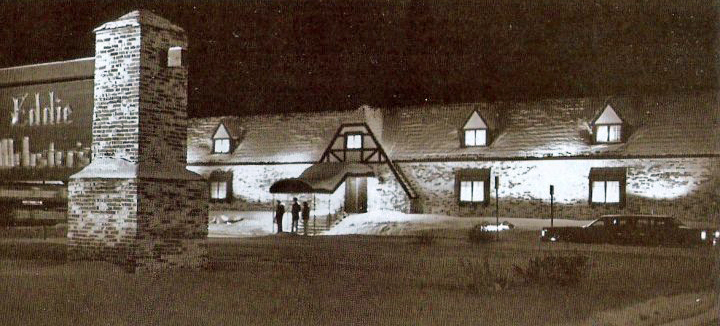
Photo courtesy Bill Webster
Things didn’t start out so well, according to a scathing review of the food by the Star’s Don Morrison on December 4, 1965. But the kinks got ironed out and the restaurant gained an excellent reputation. It was a place you dressed up to go to for special occasions with your family.
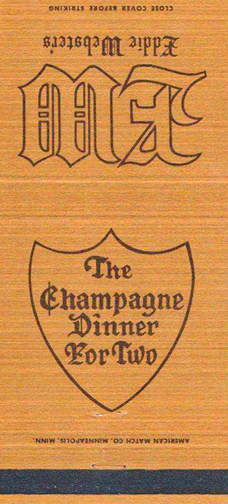
THE PEANUT BAR
Bill Webster, Eddie’s son, described the origin of the popular Peanut Bar in a Facebook post:
Eddie’s was the original “Peanut Bar” that I know of in the country. It originally was called the “Pub,” a “working man’s” bar. He was insistent on the bartenders pouring a “good drink” as he called it. My dad wanted something “salty” to give away so that people would drink more. Obviously it worked, by the number of stories [on Facebook]. He originally wanted bowls of pretzels; however the Bloomington Health Department told him everything had to be “individually wrapped” for sanitary reasons. Our cleaning lady, Mrs. Sieple, (spelling) a little German woman who spoke broken English, overheard the conversation that my dad and mom were having about this. She said, “why don’t you use peanuts, they come individually wrapped, and they are very salty, plus the shells would make a good floor cleaning compound when the people walked around on them.” (The cleaning crew originally used a sawdust compound sprinkled on the floor to absorb the spilled drinks). Hence, the “Peanut Bar” was born. Unfortunately, the little German cleaning lady never got any public recognition, other than from us, for having come up with the whole concept. My dad did take care of her, money wise, when her idea exploded into a success.
There was no live music in the Peanut Bar – the revelers apparently created their own entertainment, fueled by much alcohol.
THE CABARET
Downstairs was the Cabaret, a bar with live music, and later a disco.
DECLINE
Eddie Webster died on February 16, 1980, in a snowmobile accident in Crow Wing County at the age of 52. The business was taken over by his wife Betty and son Tom.
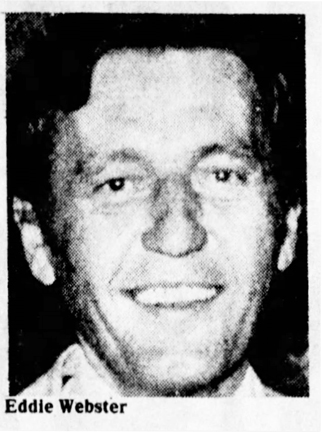
1980
By 1986 sales had become flat and the family was rethinking the concept that had been around for 28 years. One Facebook comment was that all the crowds had moved to the Cattle Co. The last day of Eddie Webster’s was April 13, 1993. Tom Webster immediately oversaw a $400,000 renovation.
CALISOTA CAFE
The renovated restaurant, now called the Calisota Cafe, opened on about April 21, 1993. The goals of the renovation were to make the restaurant more casual, offer more menu choices (130!), and make the meals less expensive. Unfortunately, the concept did not catch on, and Webster found himself unable to pay expenses, including health and pension benefits. The Calisota Cafe closed on October 14, 1993. The restaurant was auctioned off in April 1994, and Eddie Webster’s, Inc. filed for Chapter 7 bankruptcy in December 1994. The party was over.
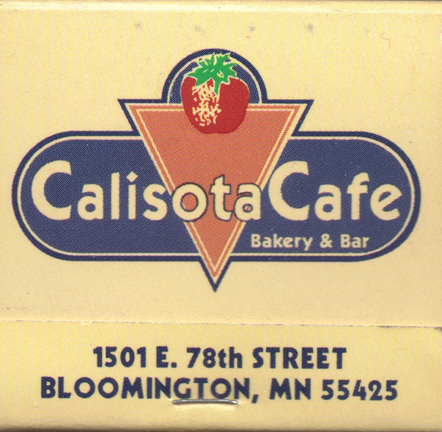
Image courtesy Brian Carlson
MORE HOTELS ON THE STRIP
The site of the old Eddie Webster’s, location of much merriment, alcohol, music, dancing, and peanuts, is now occupied by two hotels, built in 1997.
The Edgewater Inn was located at 2420 NE Marshall Street in Minneapolis. It was almost always advertised as “on the Mississippi River at Lowry and Marshall NE.”
THE SITE
Minneapolis permit cards indicate that there were frame structures on the property. One building was apparently already there before the City began record keeping. This older building was moved to 2515 NE Marshall Street in 1903.
A frame 16 x 18 office building was built in 1898. This building was moved to 2513 NE Marshall Street in 1910. The cost to move it was $30.
THE EDGEWATER INN
In December 1959, a permit was issued to build a 146′ x 77 1/2′ x 12′ restaurant and basement. It was built by Boe, Inc. at a cost of $185,000.
It opened on August 23, 1960, touted as the only restaurant in the Twin Cities located directly on the waterfront.
Opening night featured Jack Medell and his Orchestra with vocals by Patti Sherwood. “Valerie” presided in the piano lounge.
In about August 1961, the restaurant began a series of monthly art shows.
Also in August 1961, the management began bringing in outside entertainment, beginning with its first anniversary show with Joe Conti, “a stand-up comedian of the firehose type who spits out jokes for an entire hour,” according to Will Jones of the Tribune. (August 25, 1961)
Other comedians followed, coming off of TV programs like the Jack Paar Show. In November 1961, one of the comedians was Don Marlowe, host of the afternoon movie on TV’s Channel 11. Forrest Powers reported in his radio and TV column in the Star that Marlowe had played Porky in the “Our Gang” comedies and had lots of more entertaining stories between sets. (November 2, 1961)
In December 1961, the Twist descended on the ‘Cities, and “even the silver-haired Jack Medell has taken to playing the twist for dancers at the Edgewater Inn,” reported Will Jones of the Tribune on December 22.
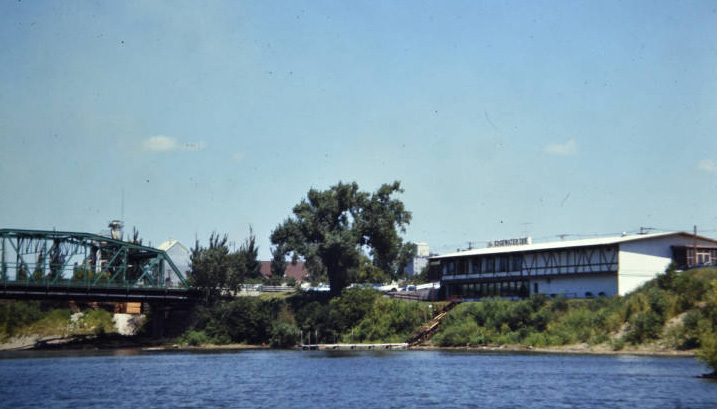
The Edgewater in the 1960s. Photo courtesy Hennepin County Library.
Medell was replaced by organist Bob Paige and the Esquires in February 1962. (Will Jones, Tribune, February 26, 1962).
By August 1962 the club was advertising heavily, featuring the music of Don McGrane and his orchestra in the main dining room.
It was immediately popular as a meeting place, wedding reception venue, fashion show site, and more.
THE EDGEWATER EIGHT
On October 25, 1962, the Edgewater Inn first presented the Edgewater Eight. Dan Sullivan of the Tribune reported that this was a “new concept in night club entertainment.” The group of young singers would present medleys of Broadway show tunes in the round on the dance floor. (October 21, 1962) Don McGrane’s Riverboat Orchestra. Produced by Al Sheehan.
A December 1962 ad for a men’s night out (supposedly to buy lingerie for their wives) tells us that there was a Mark Twain Room. (
In 1963 the restaurant advertised that it charged no cabaret tax before 8:00. This was a new tax on places that provided entertainment, and was apparently short-lived. In April 1963, Gil Swenberger was the manager of the restaurant.
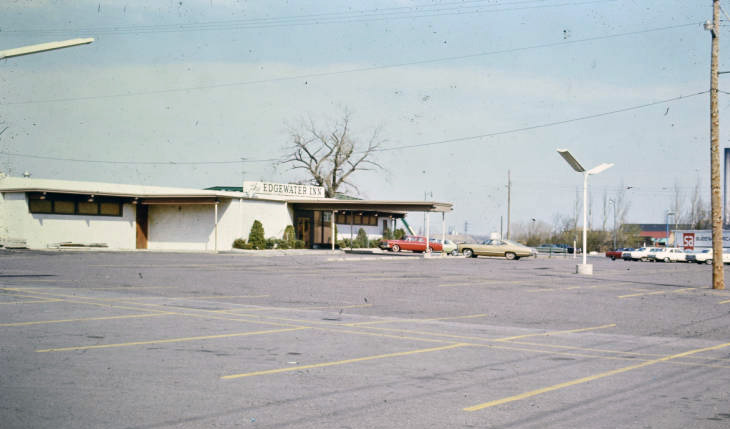
From the parking lot. 1968 photo courtesy Hennepin County Library.
Jimmy Bowman was a regular in the cocktail lounge starting in mid-1965.
1969: dance music by Frank Oliver and his Orchestra
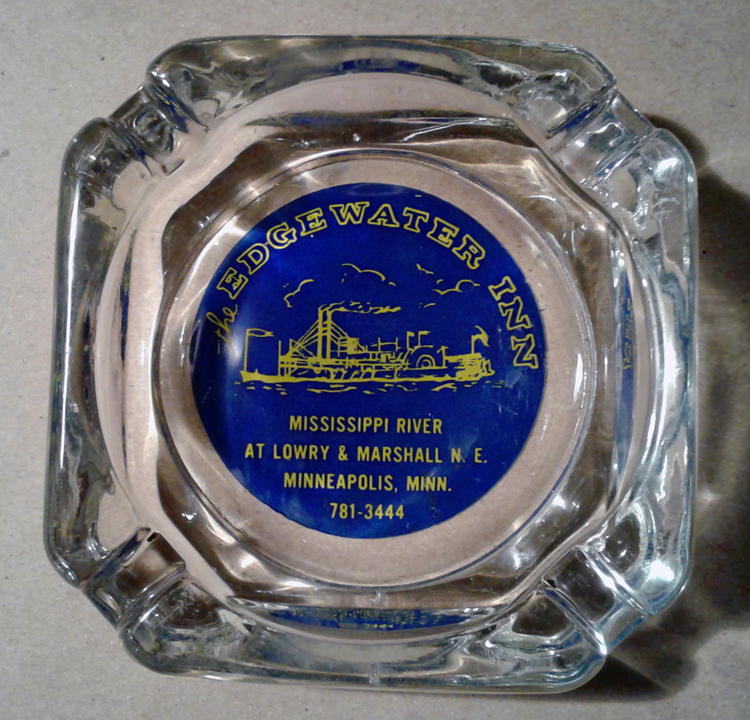
Courtesy Gary Tverberg
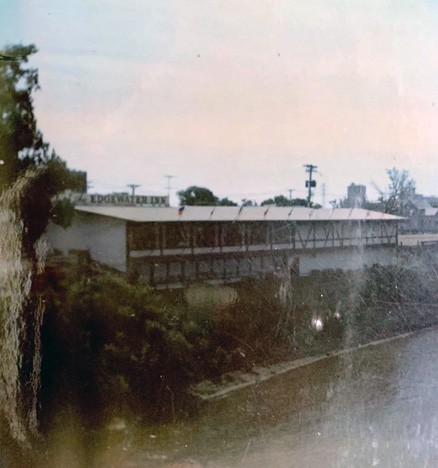
Another view from the River. Photo courtesy Linda Chapple.
A 1978 article on restaurant designer John Neal revealed that he was the designer of the club. (February 17, 1978)
RIVER PALACE
In 1984 the club had become the River Palace Dinner Theater, featuring Chinese food. In October 1984, the River Palace brought back the Edgewater-type shows of earlier days. The River Palace lasted until at least 1987 and possibly to 1990.
Minneapolis records show that the land was sold by Centennial Investment to the Minneapolis Park Board on October 9, 1992, and July 15, 1993, perhaps in two parcels, both recorded as for $1. A map in the Star Tribune identifies it as River Palace Park. (November 6, 1995)
The El Morocco and adjoining Kin Chu Cafe were located at 723-725 Hennepin Avenue. With a name like that, there had to be music!
There were thousands of hits on the Strib database, mostly for Gotham city, natch. But the bar had a bowling team in December 1939, so there’s a clue. But what’s this? The Grand Opening is announced for April 5, 1940. Guess the bowlers got a head start.
In 1946 a fellow named John Lee got busted for selling “strong beer.” Apparently it was only a 3.2 joint. Mr. Lee said it was all a mistake, and the strong stuff accidentally got mixed up with his regular stock. The arresting officer said it looked like strong beer, tasted like strong beer, had a label on for strong beer, and was, in fact, strong beer. The judge continued the case.
In 1950, Walter Wang was the operator of the bar, we learn from a dumb criminal report. A guy broke in but couldn’t break out, so he called the cops.
In December 1962 a bartender was caught taking bets on sporting events by the morals squad. Yes, the morals squad.
On December 27, 1963, a 28-year-old man was found dead of a gunshot to the heart in the bar’s basement washroom. The gun was his and was found nearby.
In September 1969, a parking lot attendant with a permit to carry a gun got clumsy and dropped his holster – the gun went off, and the bullet went through a barstool and into a female customer. The lady was hit in the hip and was in serious condition.
The establishment was demolished in about September 1970. Maybe there was no music.
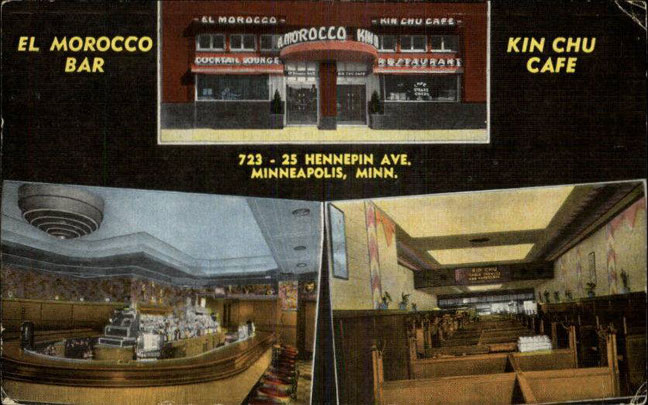
1950. Photo Minnesota Historical Society.
Much of the following information on El Patio and the Cotton Club is from Kent Hazen, and the book Joined at the Hip, A History of Jazz in the Twin Cities, by Jay Goetting (Minnesota Historical Society Press: 2011). I originally wrote this page for the St. Louis Park Historical Society. Please contact me if you have any additions or corrections.
The building at 5916 Excelsior Blvd. in St. Louis Park, now Bunny’s Bar and Grill, has a rich history. This page will tell the story of the various restaurants – most of them music venues – that have existed here. They are:
- The El Patio/Cotton Club
- Culbertson’s
- George Faust’s
- Anchor Inn
- Bongiorno’s
- Duggan’s
- Bunny’s
PREHISTORY
According to City tax records, the building was built in 1920. At that time, the adjacent Brookside neighborhood, not even 15 years old, was flourishing, and the older Center neighborhood was a few blocks down the street, although what is now Alabama Ave. may not yet have not gone through. The Dan Patch Railroad had come through in 1915.
In 1958, Cedric Adams wrote in his entertainment column that the building started out as a farm house. The building was originally all frame construction. Adams wrote that some enterprising businessmen turned it into a lumber yard to increase profits. A few years later, “another man of vision” converted it into a cabaret, and the El Patio was born. (Minneapolis Star, April 8, 1958)
1929
EL PATIO – THE COTTON CLUB
The El Patio, pronounced “el PAY sho,” was a cafe, dance hall, and after Prohibition ended in 1933, a tavern. One of the classiest establishments on the Boulevard, in the early days it catered to the Country Club and University crowds. Although there were plenty of cafes and speakeasies along Excelsior Blvd. closer to Minneapolis, the El Patio was ‘way out on the outskirts of town, before Highways 7 or 100 were built in the 1930s.
According to the ad below, it opened in May 1929, four years before Prohibition ended. However, the ad may be announcing its opening for the season; a 1940 ad announces its 12th anniversary, taking it back to 1928.
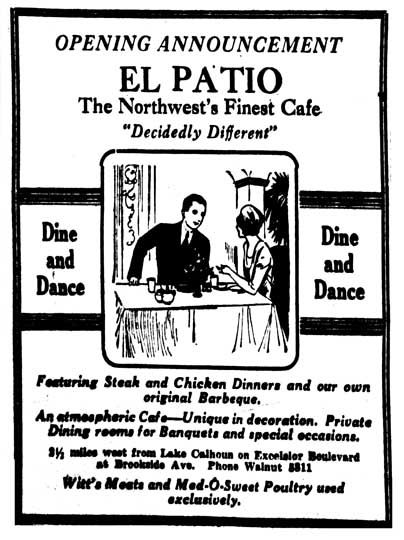
Minneapolis Tribune, May 24, 1929
Owners
The owners were collectively known as “the Greeks.”
- In December 1932 Village Council minutes identify James Spain as the President of El Patio Cafe, Inc. This was no doubt a misspelling of James Spaise. Spaise was born in Greece in 1894/5, and lived in Minneapolis and worked as a waiter (1930) and proprietor (1940) of a restaurant, according to the Census. He was named as an owner of El Patio, along with George Broumas and John Eliopolos, in a 1939 newspaper account. In December 1945, O. James Spaise was listed as an owner of James’s Barbeque at 1414 Nicollet, identified as “former owner El Patio.”
- John Eliopolis (or Elipoulos) was born on May 22, 1897, in Greece. He came to the U.S. in 1917. In the 1920s he lived in Minneapolis and was listed in directories as a cook. In the 1930 Census, he and George Broumas (below) were listed as living on Excelsior Blvd. (no street address given), both single and working as cooks. He died in Greece in January 1979. See a picture of John under 1939 below.
- George Efstathion Broumas was born on January 5, 1890, and came to the U.S. in 1911. In the 1930 Census he was single, working as a cook in a cafe (with John, above). George died in Athens on October 18, 1972. His last U.S. address was 3973 Alabama, a house that was built in 1927, adjacent to El Patio. At the time of his death he had a wife, Sophia.
- John E. Ellis was born on July 24, 1899, in Greece. He came to the U.S. in 1911. In the 1930 Census he was listed as a waiter at a road side inn. In 1940 he was a partner/proprietor of a cafe. Both years he was single, living with his brother George in Crystal. After he sold El Patio he went on to run Ellis’s Log Cabin Restaurant in Crystal. Ellis was a prominent member of the community, belonging to the AHEPA Lodge, Compass Lodge AF & AM, Zuhrah Temple, and Robbinsdale Lions Club. He died on January 13, 1976, in Golden Valley. He was survived by his wife Canella (Feb. 6, 1921 – Oct. 26, 2000) and daughter Stavroula Joanne.
- George Ellis was born on June 16, 1891, in Greece and came to the US in 1907 or 1914. In the 1930 Census he was a cook at a roadside inn, and in 1940 he was a partner/proprietor of a cafe. George lived in Crystal with his wife Sophia, three sons, and brother John.
- George A. Katsmedas was identified as a former owner of the El Patio in his obituary when he died on July 20, 1951, at age 70. He had lived in Minneapolis for 30 years and had a few restaurants since 1927.
According to a former waitress at El Patio, “The Greeks” were strict on liquor, although one Sunday night a big band came in and a lot of “cold coffee” was served. When 3.2 beer (“select?”) became legal in 1933, customers would buy a bottle and supply their own harder stuff. During the Depression, El Patio provided meals to the needy.
On the Radio
From very early on, music was part of the dining experience at the El Patio. On September 11, 1929, an ad was placed for a five-piece orchestra for the El Patio Cafe, Brookside, Minn. [In those early days, for some reason, Brookside was often identified as if it was its own village, although it never was. St. Louis Park was a collection of disparate neighborhoods, and Brookside was just one of them.]
Orchestras played for dancing and their music was broadcast over the radio over telephone wires. The first station was WHRM, a long defunct radio station, with broadcasts starting in October 1929. Broadcasts moved to WDGY in December 1929, with music by Polta’s El Patio Orchestra and the El Patio Play Boys.
The ad below may be hard to read, but it reflects an ambitious menu, and announces that the Mill City Blue Boys were on hand for musical entertainment.
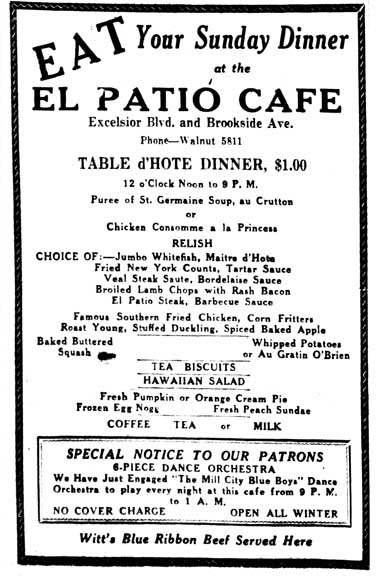
Minneapolis Tribune, September 28, 1929
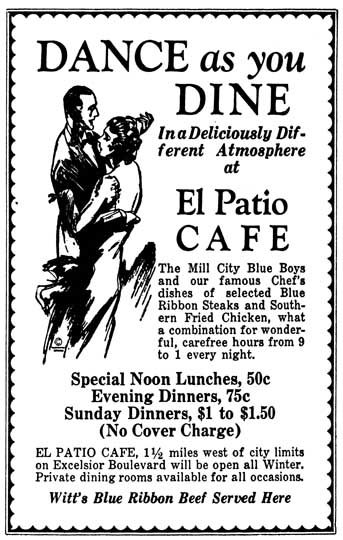
Minneapolis Star, October 25, 1929
1934
The Cotton Club
For several years, El Patio was concurrently known as the Cotton Club, named after the famous nightclub in Harlem (1923-1940). (There had been another Cotton Club in Minneapolis at 6th Ave. N. and Lyndale.) When the Apex Club in Minneapolis was shut down in 1934, club manager Pete Karalis signed the musicians and looked for a place for them to play. The Census lists a Peter G. Karalis who was born in Greece in 1888 and came to the U.S. in 1903 with his brother Christ.
Karalis said, “I sold the idea to the four Greek boys at [El Patio]. [One source said Karalis was a relative to one or more of the Greeks.] I then auditioned the group with Bob DeHaven and Lee Whiting at WTCN. They really liked the group and said they’d give me a line out there for thirty-nine dollars a month. I spent the remainder of my capital on paint to write ‘Cotton Club’ on the roof. We had a fairly good dinner trade, and the boys were proud of their restaurant… The group used to play the dinner shift.” (Joined at the Hip, page 83)
There was a reference to the “Cotton Club (El Patio)” in the 1934 Echowan St. Louis High School yearbook. An article about a fight in June 1934 referred to the place as “a tavern known as ‘the Old Cotton Club’ on Excelsior Blvd.” Other physical evidence of it is in the 1937 village directory, which listed the establishment as El Patio-Cotton Club. Otherwise it was referred to only as the El Patio in Village Council Minutes and village directories.
PHOTO OF THE EL PATIO
The only known photo of the El Patio is the one below. One can clearly see the “El Patio” vertical sign over the shoulder of the man on the right. If you look long and hard enough, you can see that the roof says “Dine [and] Dance” and, underneath, “Cotton Club.” A closeup of the photo reveals that the license plate on the car they are leaning on has the year 1941 on it.
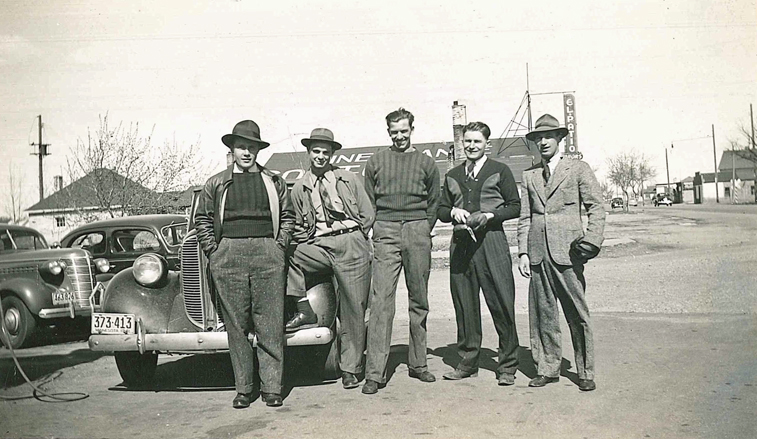
Photo donated by Bob Felber
Although these men might look a bit menacing, they are just St. Louis Park school friends, all born in 1916 and 1917, and all in their early 20s in this photo. They all registered for the draft on October 16, 1940. They are:
Bill Finnegan, who lived at 4708 W. 43rd Street. In 1940 he worked as a truck driver for Suburban Drayage, which might mean that he was a garbage man. He served in the Navy from 1942 to 1946, died in 2008, and is buried at Fort Snelling.
Bob Felber lived at 5924 Oxford Street, and worked at the lumber yard across the street from El Patio. He served in the Army Air Corps in World War II from 1942 to 1945, died in 1993, and is buried in Sioux Falls.
Richard Dahlquist lived at 6230 Cambridge, and in 1940 he was a student at the U of M. It appears that either because of his student status, or because of his height (6′ 4″), he did not serve in the War. He died in 1991 in Indiana.
Henry Swoboda lived at 6015 W. 37th Street, and in 1940 he delivered groceries for Swenson’s Market on Walker Street. At the time he registered for the military in 1941 he worked at Pockrandt Lumber on Highway 7. He served in the Army from 1942 to 1946.
Kent Hazen: “Karalis brought in Boyd Atkins from Chicago to lead the band of local musicians he then presented at the Cotton Club. Among the local players were trumpeter Rook Ganz and tenor saxophonist Harry Pettiford. Atkins was a composer/arranger of some stature who also played reeds and piano. In 1935 Karalis brought in Lester Young to replace Pettiford. Young was with the Atkins band at the Cotton Club in 1936 when he received a telegram from Count Basie asking him to join his band back in Kansas City. Lester made his seminal recordings with Basie that same year.”
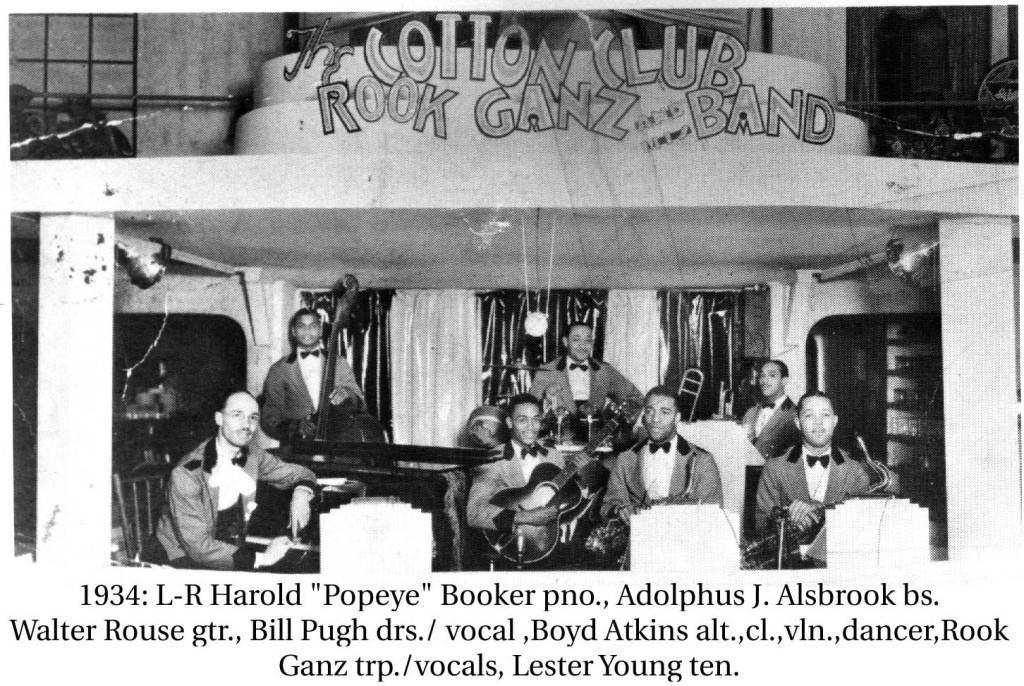
“One of the earliest assemblages of world-class talent on a Twin Cities stage was the Cotton Club or El Patio in St. Louis Park. Joined at the Hip, page 39.
Again from Joined at the Hip: “The place was clean, neat, well run, and without rough stuff. It was the more established and familiar Minneapolis musician Rook Ganz whom people came to hear. George Putnam, later with Pathe News, was the radio announcer … Lester would leave the bandstand for some of his solos in order to stroll and serenade the diners at their tables and booths.” (page 84)
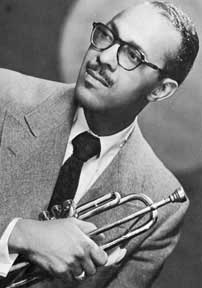
Rook Ganz
Drummer Bob Burns described how jam sessions at El Patio often turned into all-night affairs: “We started work at nine o’clock with a six-piece orchestra; at one o’clock, we cut down to three; by one-thirty, we’d have fifteen to twenty men on the stand, everybody blowin’. This was not only local musicians, but, remember, it was the era of the big band: Benny Goodman, Tommy Dorsey, Jimmy Dorsey, Glenn Miller – men like that on the stand at the same time. We’d work there until three o’clock in the morning, shut down, then go up north where Rook and the other fellas were playing. We’d stay there ’til eight, nine o’clock in the morning. If some of that music could have been recorded, I’m sure it would go down in the archives of history as some of the greatest ever performed.” (Joined at the Hip, page 92)
Hazen: “Atkins led the Cotton Club band until 1940, when he moved on to lead a band at a club in Peoria, Illinois. In the 1950s & ’60s Atkins was deeply involved in the Chicago blues and R&B scene, including collaborations with Elmore James, Magic Sam and Muddy Waters.”
Don Lang of Downbeat Magazine wrote in the 1940s that “The Cotton Club was the last Minneapolis spot to employ a colored band.” (Joined at the Hip, page 86)
1939
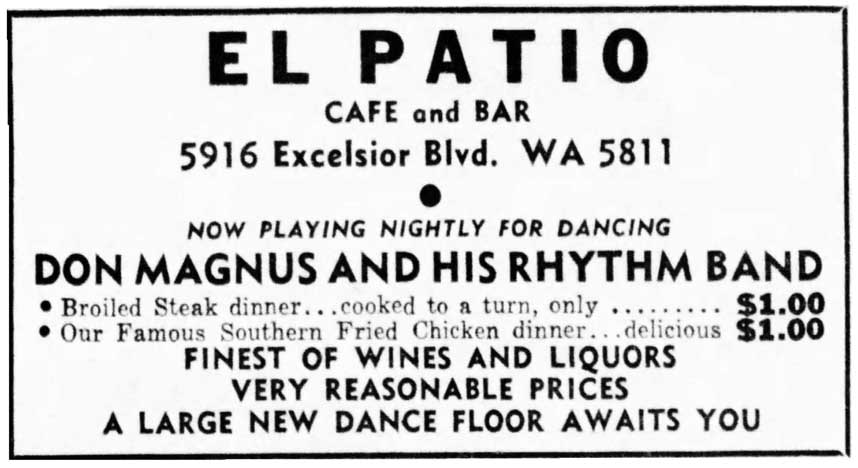
Minneapolis Tribune, April 2, 1939
Trouble at El Patio
As can be expected, having a roadhouse with black musicians playing hot jazz late into the night in a suburbanizing village was drawing more and more ire from its neighbors.
On March 8, 1939, the El Patio was fined $25 for staying open after hours. On March 11, bartender-partner James Spaise was fined another $50 for “permitting minors to be in a place where intoxicating liquor is sold.” This was the result of an incident on February 25, 1939, when three youths lied to Spaise about being 21 and were served drinks. The other two partners, George Broumas and John Eliopolos, were not fined because they worked in the kitchen and did not have contact with patrons.
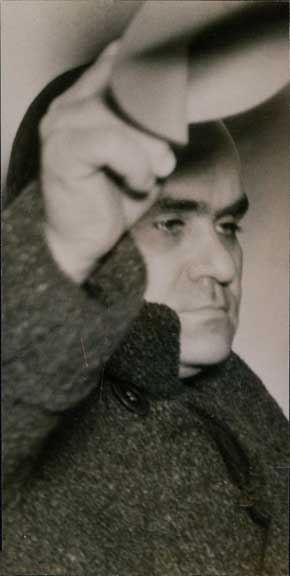
John Eliopolos, as he was exonerated from charges. Photo from police files, courtesy James Kenline
The two charges were filed after reports that an earlier complaint had been quashed by the arresting officer because of pressure from his superiors. (Minneapolis Star, March 9, 1939; Minneapolis Tribune, March 12, 1939)
This controversy led to another, and a few days later, the Minneapolis papers seemed to be making fun of St. Louis Park’s problem. One article began,
“Jitter bugs” prancing to strains of “hot music were blamed for revocation of the tavern and 3.2 beer licenses of the El Patio Cafe on Excelsior boulevard by the St. Louis Park city council.
The citizen who brought the problem to the council’s attention at their meeting on March 13, 1939, was one Norman Hague, who vehemently opposed allowing the joint to jump after closing time. After his impassioned speech, the council voted to revoke the cafe’s 3.2 beer license (but not the hard liquor license). They also revoked its tavern license, which meant that there could be no dancing. The councilmen even passed a motion commending the policemen who gathered evidence against the cafe. (Minneapolis Star, March 14, 1939)
The St. Louis Park Spectator reported that Mell W. Hobart represented a committee from Brookside that insisted that something be done. The indignant crowd, and even the Mayor himself, mentioned rumors about the place; one citizen was quoted thusly: “It is a known fact that they have been catering to high school kids for years, serving near beer to be spiked.” Mayor Nelson voted that the club keep its licenses, but was the only one.
Revoking the cafe’s hard liquor license required a public hearing, however, and that was held on March 20, 1939. A packed house of 65 people came to voice their opinions, and most of them were the complete opposite of those expressed at the council meeting the week before. Jack McCarthy asserted that the cafe had a “good, clean operating record for the past 10 years, and complaints against it were few and far between.”
Peter E. Kamuchey, attorney for the cafe, went as far as to say that “The El Patio is run almost as well as a minister operates a church.” “These boys have run the place 10 years without a single conviction until this last trouble.” Fred Peters opined that closing the cafe was too stiff a penalty for the violation, and would throw a score of people out of work and cost the village taxes.
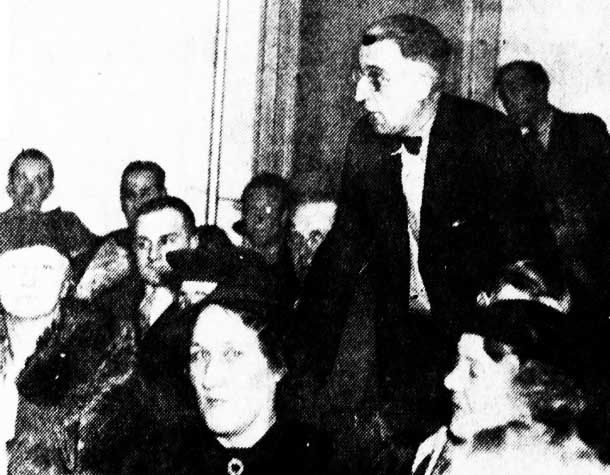
Fred Peters at the March 20, 1939, Village Council Meeting. Minneapolis Star, March 21, 1939
“This is the best joke the Minneapolis newspapers have ever had,” shouted Jack Drummond when a photographer’s bulb flashed. “Let’s get it settled!” After the Villagers revealed an “overwhelming sentiment in favor of permitting the cafe to continue operation,” the council voted not to revoke the tavern’s hard liquor license, with the exception of Torval Jorvig, who voted against all liquor establishments.
At the next village council meeting on March 27, 1939, the council renewed the cafe’s tavern and 3.2 beer licenses it had revoked earlier. The Minneapolis Star, still making fun, wrote that “More interest was expressed last night in selection of a village dog catcher.”
1940
The ad below indicates that the El Patio was shut down for remodeling in 1940. Those changes were made in masonry. It also indicates that the place opened in October 1928?
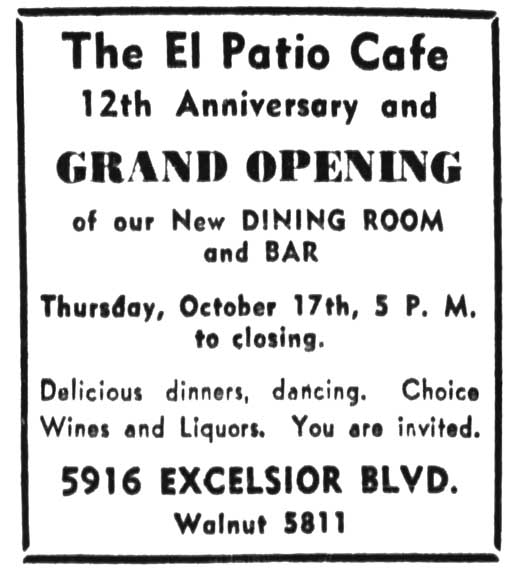
Minneapolis Tribune, October 17, 1940

St. Louis Park Directory ad, 1941
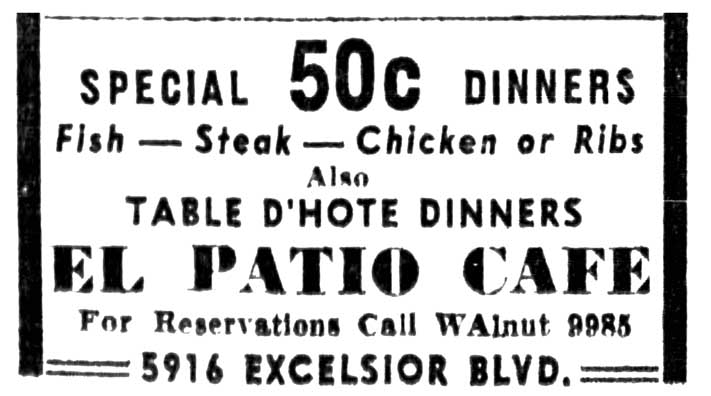
Minneapolis Star, June 19, 1942
1945
An odd item about the El Patio appeared in the Minneapolis Star on October 11, 1945, with the headline “Gypsy ‘Gyp’ Band on Job, City Warned.” The article warned of two families of Gypsies who were victimizing businessmen from Massachusetts to Minnesota. Seems they had poured asbestos cement into three ovens at the cafe “to insulate them,” charging $200 for their service. The Better Business Bureau heard about it, and repairmen from the Minneapolis Gas-Light Co. had to remove it before there was a serious explosion. On top of that, legitimate repair work should have only cost $25 an oven, gas company officials estimated.
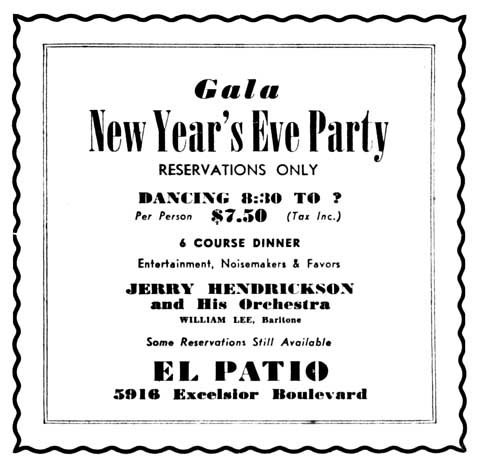
Minneapolis Star, December 26, 1945
1946
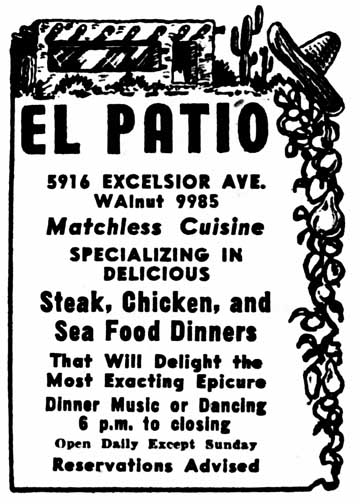
Minneapolis Tribune, July 24, 1946
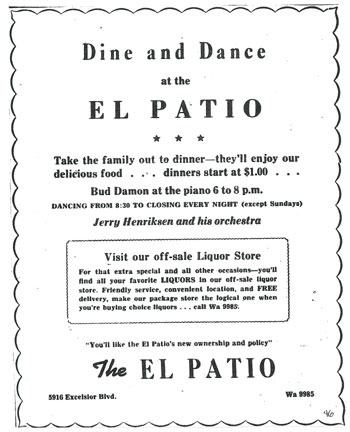
1946 Directory ad
El Patio Closes
On August 8, 1946, the Tribune published an ad by the El Patio, selling 20 complete leatherette booths and tables in “A-1 condition.”
The ad below indicates that El Patio would close its dining room on Monday, August 26, 1946, for remodeling with the intention of reopening at some time that same year under “new ownership and policy.” The bar would stay open during renovations. A neighbor remembers that it was closed for quite awhile before opening again as Culbertson’s.
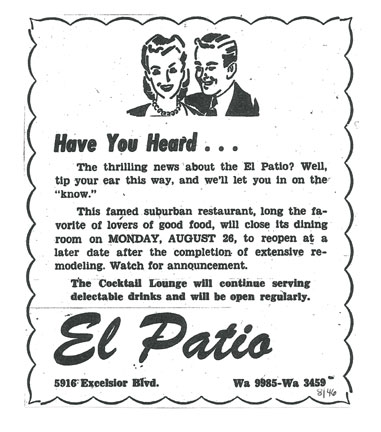
August 1946
CULBERTSON’S
According to a sports article in the Minneapolis Star, Ted J. Culbertson opened Culbertson’s Cafe on August 19, 1946. That does not compute with the ad above that says that El Patio would close on August 26. But it did exist in September 1946. Go figure.
This restaurant, an upscale steakhouse, was said to be patronized mostly by people outside of St. Louis Park. Journalists were known to hang out there. In the early 1940s, Ted Culbertson had been a co-owner with Keith McCarthy of McCarthy’s Cafe.
1947 – 1948
In 1947 the building was in pretty bad condition when the Building Inspector wrote a letter to the Village Council citing numerous violations. Things were apparently cleared up, and on August 24, 1947, an ad was placed announcing that Culbertson’s was now fully air conditioned.
A 24’ by 60’ room was added on the west side in August 1948, according to city building permits.
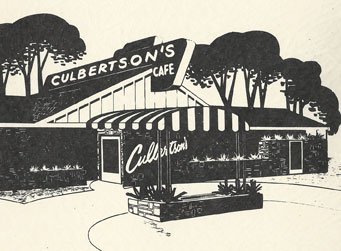
Undated sketch
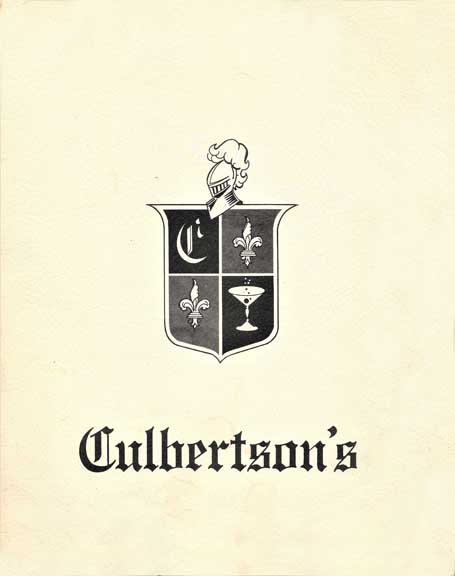
Culbertson’s menu – image courtesy Scott Smith
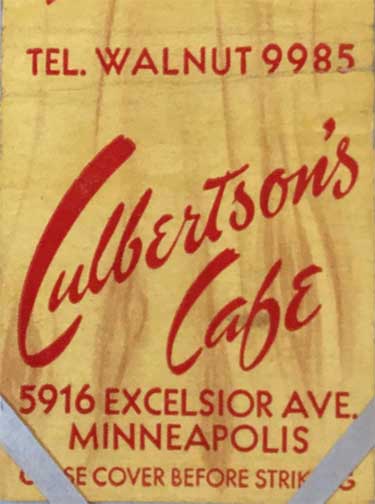
Matchbook image courtesy Mark Youngblood
1949
The photo below is dark but shows the building’s lines and front entrance on Excelsior Blvd. in 1949.
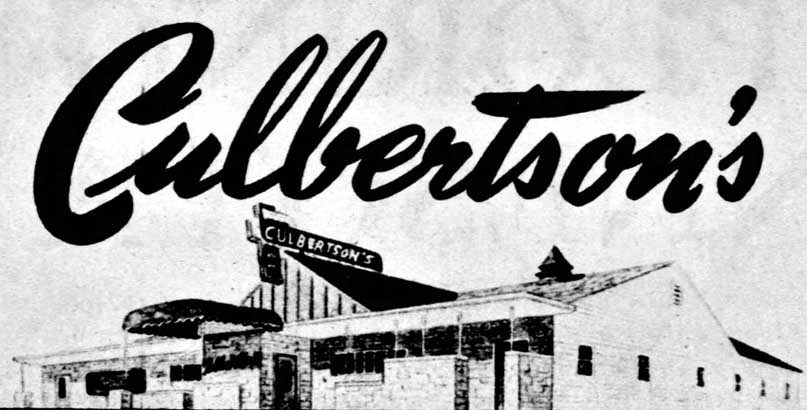
Minneapolis Tribune, August 18, 1949
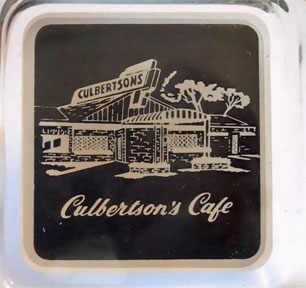
Image of ashtray courtesy Mark Youngblood
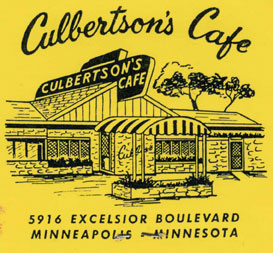
1955
The photo below from 1955 shows many interesting things: the proximity of the club to the railroad tracks, suggesting that patrons might have taken the train to this outpost way back in the 1920s. Also, the original portion of the building was the middle, and the rooflines of the additions faced the opposite way. Another item of interest is that the front door faced Excelsior Blvd., in an era when on-street parking was plentiful.
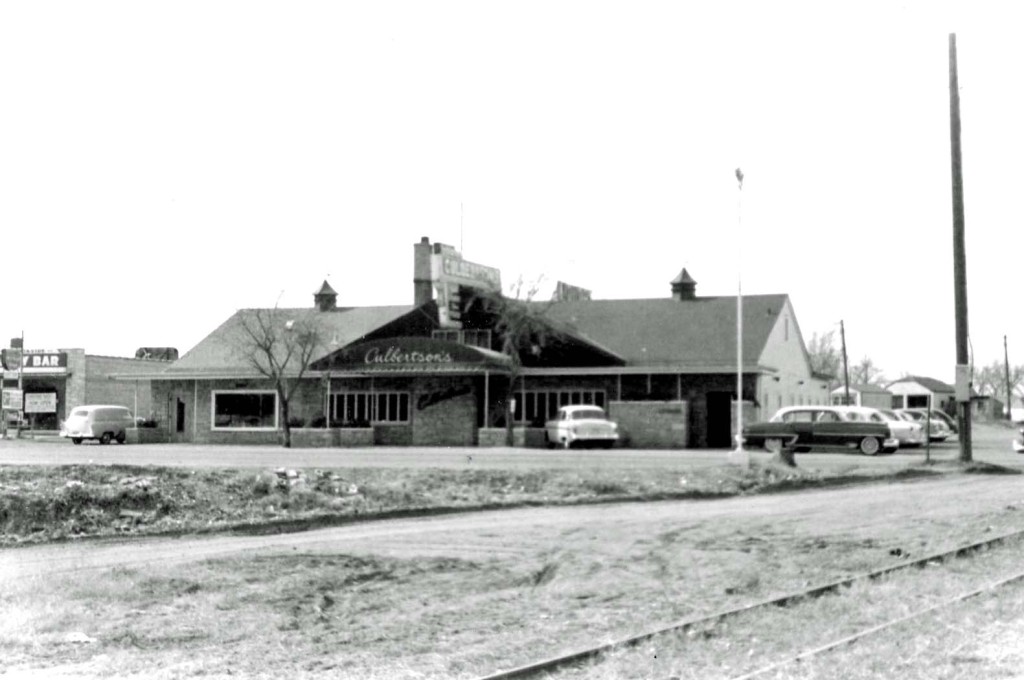
1955
1958
There was a significant fire at Culbertson’s in January 1958 (“the other night,” said Cedric Adams in his January 23 column). Adams credited hostess Ruby Berg for keeping a cool head while herding the customers out, and organist Rollie Altmeyer for playing “Smoke Gets in Your Eyes” “until he felt fire singeing his breeches” and then “There’ll be a Hot Time in the Old Town Tonight.” (Minneapolis Star)
In response to the fire, Ted Culbertson and his partner Elden Rothgeb decided to do the entire cafe over from vestibule to kitchen, reported Adams on the following June 13. Work consisted of:
- An enlarged, all-formica kitchen, “only one of its kind in the world,” which will turn out 200 steaks at once from its gas broilers.
- A renovated dining room with new tables and chairs, and new booths that will seat 150. This was later amended to 500, with four private dining rooms that could be divided into seating arrangements from 12 to 150.
- Carpeting and a “multi-vaulted ceiling” to deaden the noise to a murmur. Adams alternately described the ceiling as “lowered and acousticised.”
One of the many charming features of the place was a “pass-through” from the ladies room to a service bar, so that ladies could get drinks without their husbands knowing about it.
Boe Construction Inc. built the addition, which Adams reported to have cost $250,000. He also said that it was done without the loss of a single day’s business. And in the end, there was only one main wall left of the old Culbertson’s and the old El Patio. Adams had his facts wrong about timing, though, so let your eyes be your guide on that one.
Adams was an entertainment reporter, though, and he did write that Rollie Altmeyer played organ music for the dinner crowd, and then headed a three-piece combo for dancing in the dining room. Singer Auzie Dial held forth in the piano lounge. (Minneapolis Star, August 8, 1958)
1960
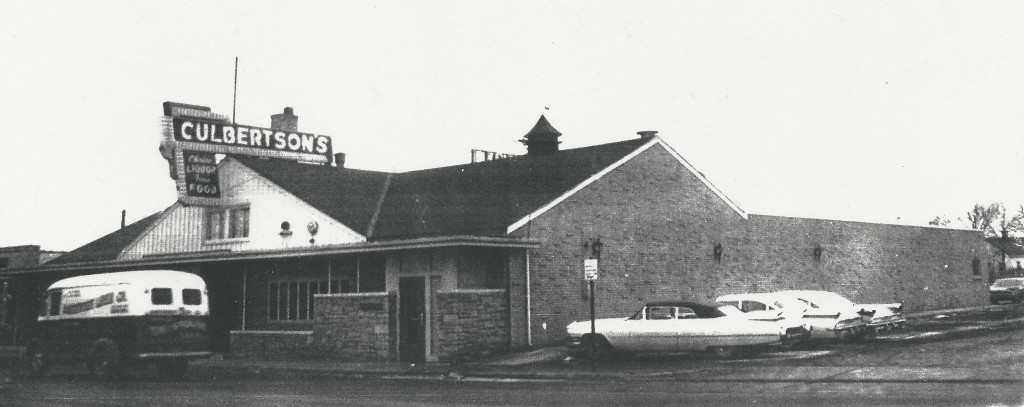
1960
Harry Pence and the Dan Patch
An oft’ told story may have started with Cedric Adams, in his entertainment column in the Minneapolis Star dated March 11, 1960. It may be true, it may not. It may have happened in 1960, it may have happened in 1920. We do know that Harry Pence took over the Dan Patch Railroad in 1916 when Marion Savage died. But Harry Pence died in 1933. But there was another Harry Pence who was a pal of Ted Culbertson in the 1950s, perhaps Harry, Jr. Here is the entire article.
A St. Louis Park policeman burst into Culbertson’s cafe the other night shouting, “Anybody in here who parked a new Cadillac on the railroad tracks just outside the door?” A voice from inside answered clearly, “Yes, I did.” The cop approached the owner of the voice, Harry Pence. “Don’t you think you ought to take that car off the tracks?” “I don’t know why I should,” Pence responded. “I’m president of the railroad.” “But supposing a train came by?” the cop questioned. To which Pence replied, “Look, don’t you suppose as president of the railroad I know when our trains are running?” The car stayed there.
1963
A further addition was built by Culbertson in 1963, according to City building permit records.
Joined at the Hip mentions that a series of live jazz broadcasts was produced by Dick Driscoll for KQRS in the 1960s (page 185). The June 1963 Twin Citian promised Entertainment nightly.
1964
Culbertson’s on-sale and off-sale liquor licenses were transferred to the Halseth Corporation on September 17, 1964. Stockholders in the Halseth Corp. were Perry Halseth, his son L. Richard Halseth, and Ted J. Culbertson. The Halseth Corp. bought the stock of Culbertson’s and operated the cafe and liquor store. Halseth was the majority stockholder and his son and Culbertson were minority stockholders.
1965
Culbertson’s was apparently a hip place to hang out in 1965. A newspaper ad from 1965 features the “Fabulous Dance Music of the Don Lee Trio,” Gayle Dunn in the Elbow Room Piano Lounge, and the Van George Professional Dancers every Wednesday night. 1965 was the year of Go-Go, so one could assume that the Van George Professional Dancers might have been in cages or worn white boots?
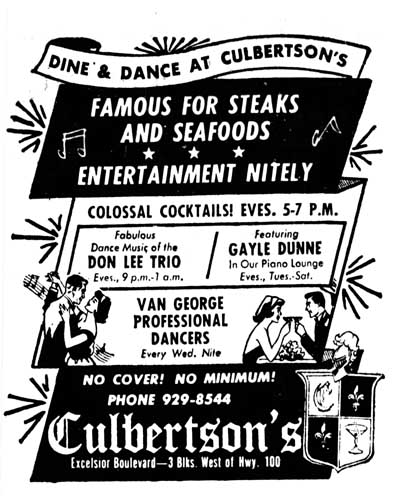
Minneapolis Star, March 30, 1965
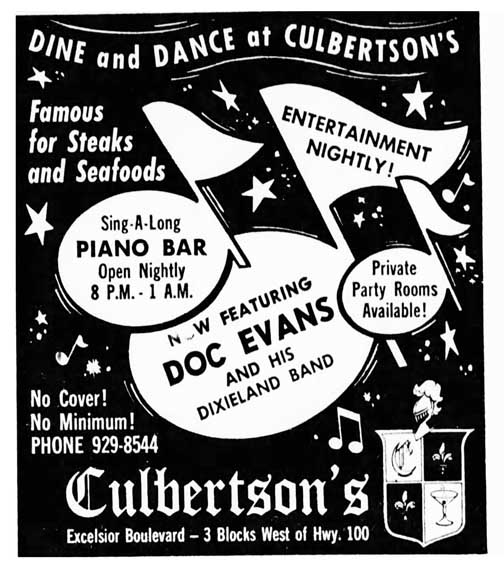
Minneapolis Tribune, June 6, 1965
In 1965 the Culbertson’s cocktail hour featured lingerie shows, as pictured in a huge photo of ogling men in the October 17 Minneapolis Tribune Picture Magazine. The photo is too dark to post, but the caption reads:
The gowns grow shorter as the cocktail hour lingerie show progresses at Culbertson’s Cafe. The Model reminds viewers that they may buy anything that catches their eye, “in the way of lingerie, that is.” Three girls do the show, taking turns as the narrator with such comments as “You’d better order another martini, ’cause we’ll be right back with some swingin’ bikinis.” One of the girls makes more money modeling 5 hours a week than she does in her 40-hour receptionist job.
1968
In 1968 there was one band in the Continental Room, one in the Back Room, and also a Piano Lounge.
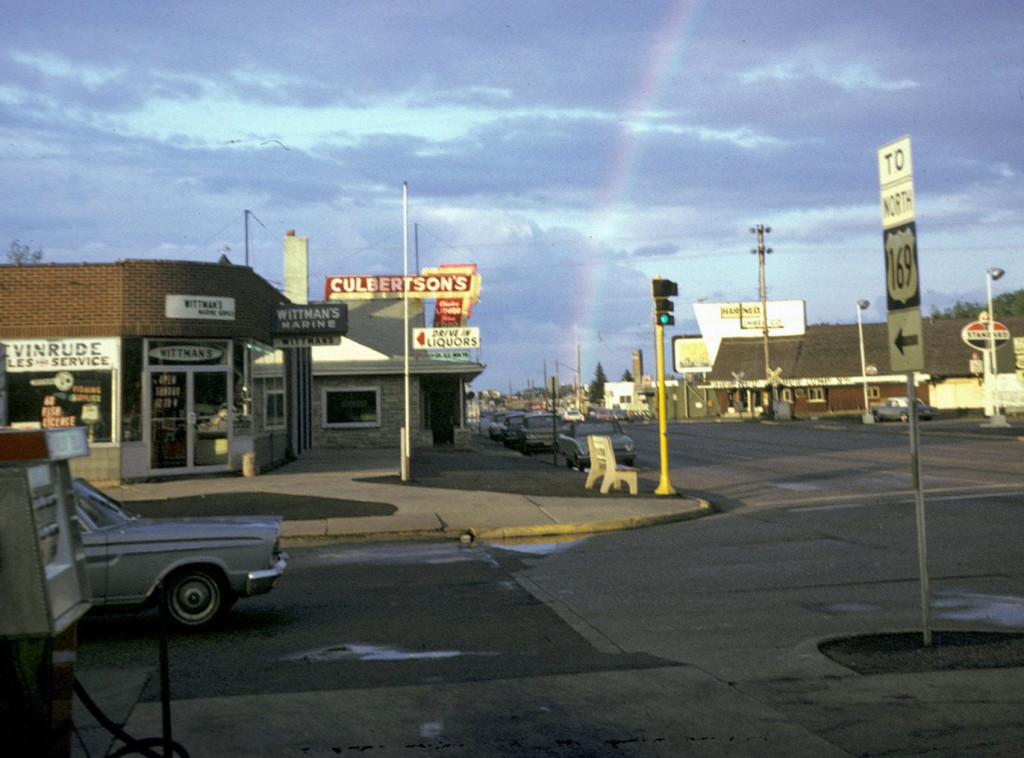
1968 photo by Emory Anderson
GEORGE FAUST’S
George Faust, a former U of M football hero, was the next to run the establishment, heading up George Faust’s Restaurant and Liquor Storium from October [December] 1968 to 1971. The liquor license was transferred from Perry Halseth. One unique draw was their raw oyster bar. A comparison of singles bars from July 1971 describes Faust’s as catering to an older “thirtyish” crowd.
Faust got in trouble a couple of times for serving 20-year-olds with fake IDs. In March 1970 the City Council ordered the place closed for 10 days, on the erroneous report that he had served a 15-year-old. The shutdown was later rescinded as being too severe, when Faust said that the shutdown would cost $10,000 and force him out of business.
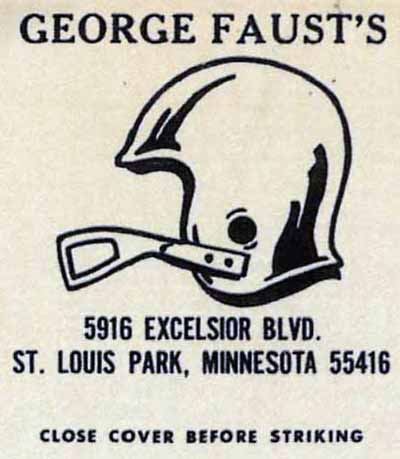
During its entire run, George Faust’s identified itself as “Formerly Culbertson’s.”
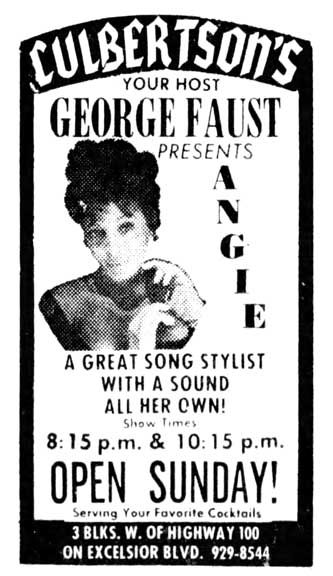
Minneapolis Tribune, September 16, 1968
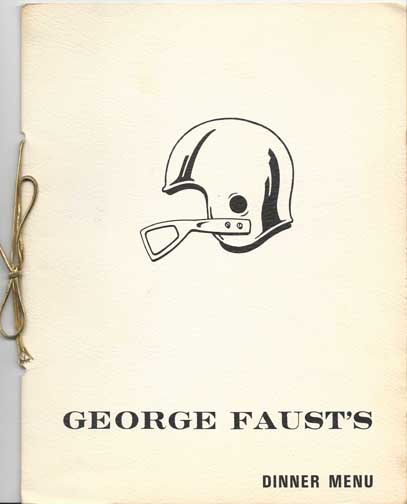
Menu image courtesy Scott Smith
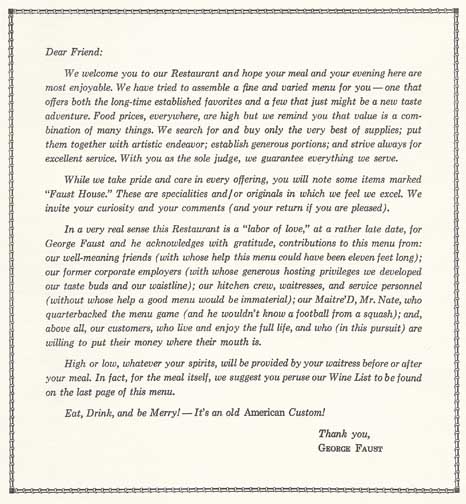
Back of menu – courtesy Scott Smith
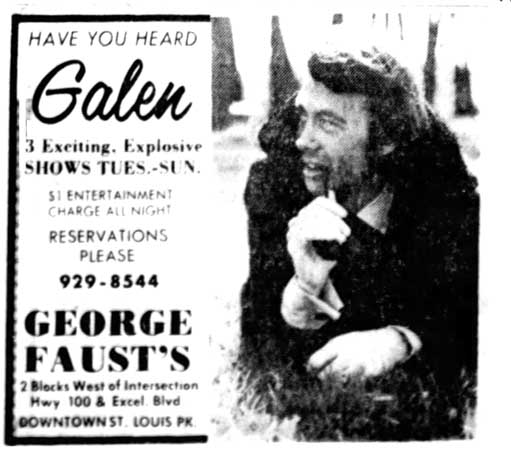
Minneapolis Star, March 12, 1971
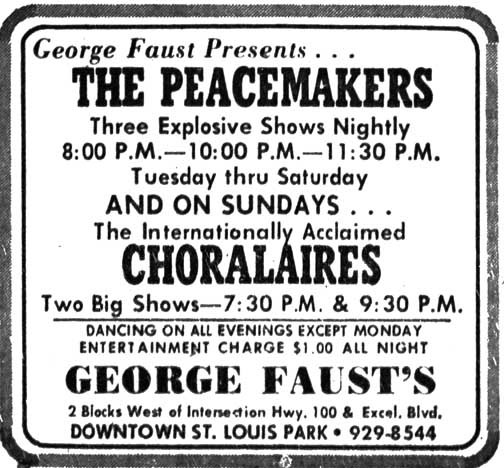
Minneapolis Tribune, May 16, 1971
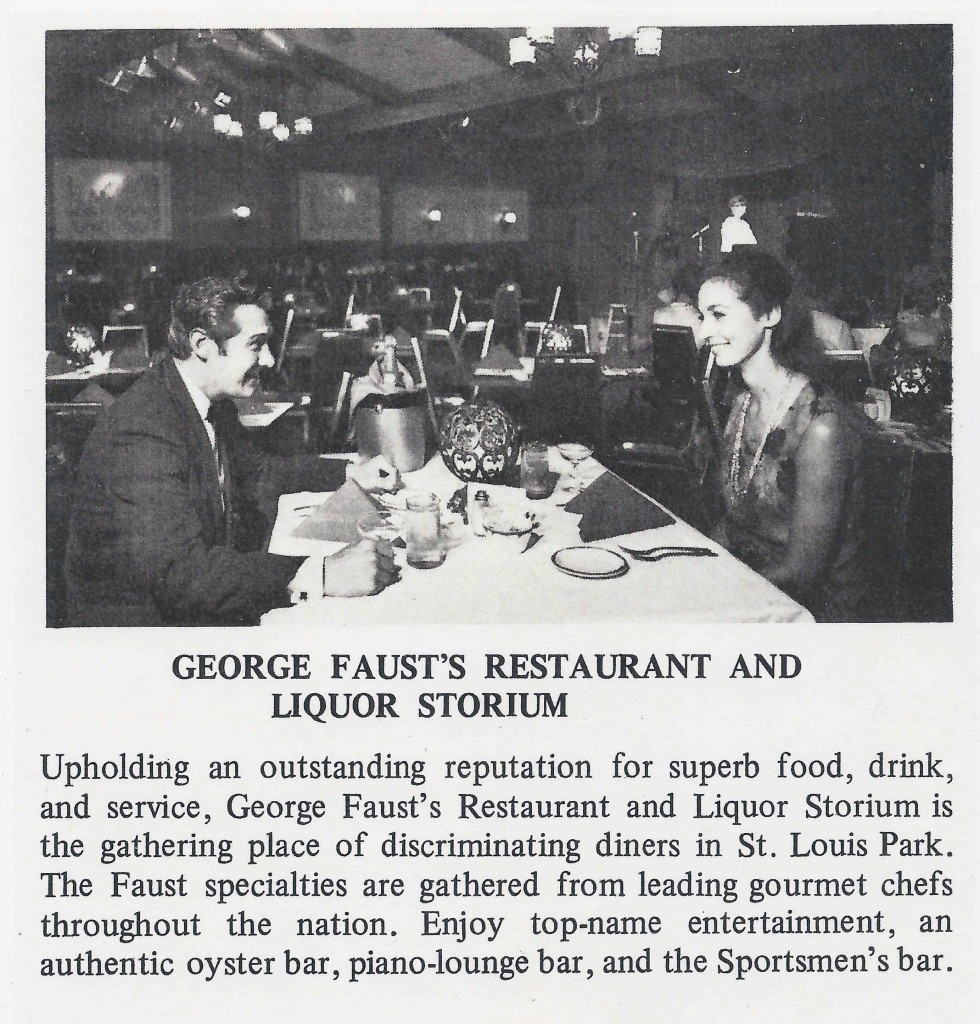
1971 Ad
One explanation of Faust’s demise is that George’s glory days were back in the ’30s, and his businessman clientele grew weary of his football stories. On September 29, 1971, it was announced in the Minneapolis Star that George Faust had sold the restaurant to Lyle Ebeling and Louis Gydesen of Minneapolis, and they would take over on Friday, October 1, 1971. Faust said he would be joining the staff of a Minneapolis firm in a managerial capacity. One source said that he went back to his previous profession selling frozen meat.
ANCHOR INN
The first ad for the Anchor Inn appeared on November 27, 1971. The Anchor Inn was a chain, and this was the second one owned by Louis Gydesen, who owned the one in Bayport.
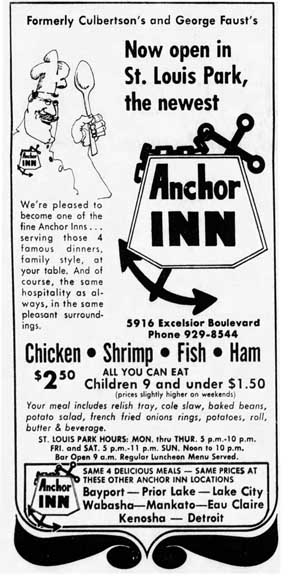
Minneapolis Tribune, November 27, 1971
The restaurant featured all all-you-can-eat format, which spelled disaster for some waitresses who had worked for Culbertson and Faust, as they received smaller tips. The restaurant had a long run, lasting until 1981.
The St. Louis Park Dispatch reported that on June 17, 1972, there was a fire that was deemed suspicious. No outcome was reported, and it did not make the Minneapolis papers.
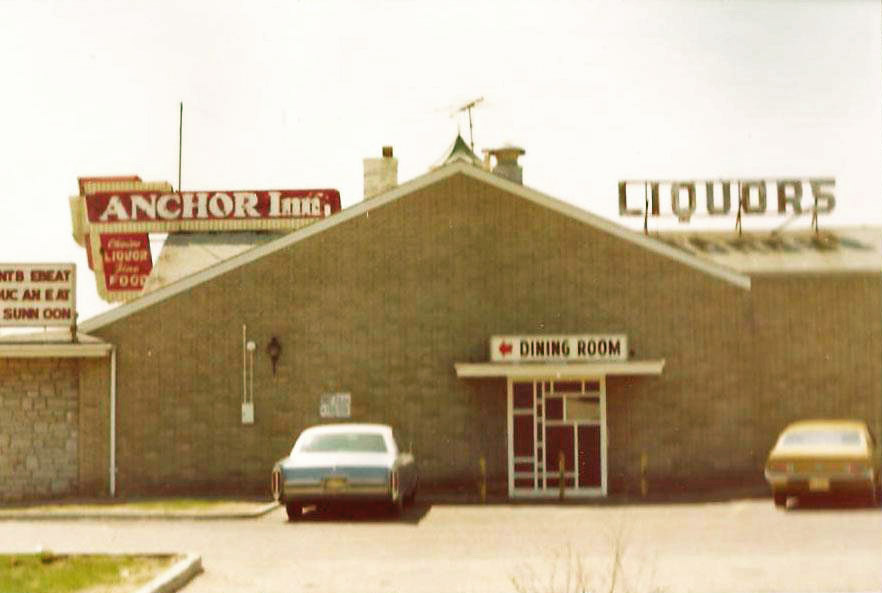
Anchor Inn 1976. Photo by Ed Engelkes, who worked there in the liquor store and was a bartender. Courtesy Heidi Engelkes Bramwell
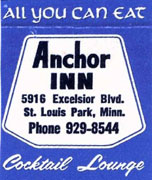
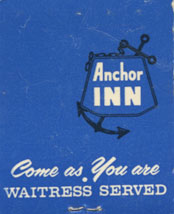
Al Hartman remembers his time working at the Anchor Inn:
In 1975 I got a job bartending at the Anchor Inn. To learn how to bartend and get the job I put in 20 hours for free in their kitchen service bar. The tag line of the restaurant was “The Home of Waitress Served All You Can Eat.” The waitresses still got decent tips, I think, (maybe not as good as working for the previous restaurants at that location but I am not sure if many had been there that long), at least I did as a bartender, but I was union also and got a good wage too. The plan for the servers was to load customers up on bread and coleslaw first. They came out with an aluminum foil covered tray with the food on it and each time someone ordered any of the all-you-can-eat food again, the portions diminished on that tray incrementally.
The menu was mostly beer battered and deep fried with chicken and shrimp being quite popular but I remember they also had unbattered ham slices. The cooks would pop up at the service bar occasionally for a pitcher of beer to make the beer batter. At one time I remember a customer complaining about the beer in the batter as he was an alcoholic and should not have the beer in anything. We all wondered why he was there then as the beer batter part of the whole thing was pretty well promoted.
There were two bars at the time: the Piano Bar on the Northeast end and the Sportsman’s Bar on the Southeast end. The piano bar had great piano players with quite a selection of songs. I enjoyed asking them to play “Hernando’s Hideaway” as it was obscure, they actually had the sheet music, and customers seemed to like to sing along to that along with my other fave “Yes, We Have No Bananas.”
The Sportsman’s Bar was better lighted. It was more no nonsense bar and had a TV to watch sports on. Bill, the day bartender, I think actually retired from there with a bartender union pension. Both of the bars had black plastic booze metering dispenser tops on their bottles to make sure just a shot was poured. Dick Chapin and Lyle’s step son Terry were both evening managers under Lyle at the time.
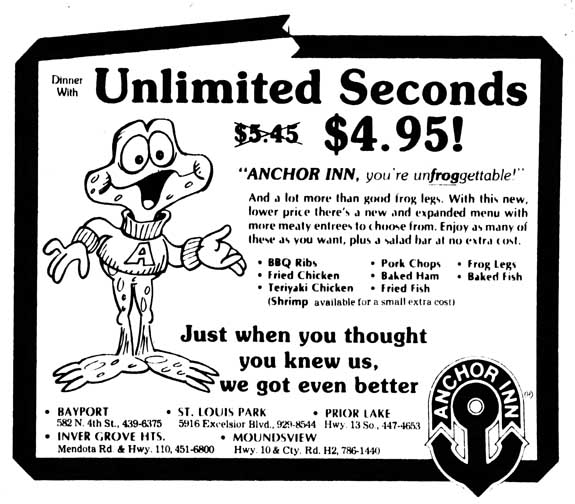
Minneapolis Tribune, June 13, 1980
The Anchor Inn closed in the fall of 1981.
BONGIORNO
David Bongiorno came to Minnesota from Erie, Pennsylvania in 1959. In about 1961 he became a co-owner of Mama Rosa’s Italian Restaurant in Minneapolis, which began as a pizza parlor in 1954. Bongiorno may have been an excellent chef, but his businesses suffered from three major disasters.
In 1971, Mama Rosa’s was hit with a strike for better pay, safer working conditions, faulty and defective equipment, a larger work force, an end to alleged discrimination in hiring, unjust firings, and longer skirts for waitresses. The two-day strike ended with pay raises and an agreement that waitresses could choose the length of their own skirts. (Minneapolis Tribune, September 2-4, 1971)
Breakfast at Mama’s opened in 1974, and was hit with lawsuits in August 1977 when 130 people got food poisoning after eating eggs Benedict. Then, both restaurants were closed on October 27, 1978, because of an outbreak of hepatitis and four people were briefly hospitalized. At the time of the hepatitis scare, Bongiorno had another Mama Rosa’s in St. Paul, and had been thinking of opening another restaurant in St. Louis Park, but business was so bad and he and his family were taking so much abuse that he was afraid for his future. (Minneapolis Star, December 8, 1978)
He sold Mama Rosa’s and opened the Bongiorno Ristorante in St. Louis Park in 1981. He advertised “Italian Food Prepared the Northern and Southern Way.” Will Jones reported that Bongiorno “got tired of all those grapevines on the West Bank and I’ve always liked the glamour of Fred Astaire and Ginger Rogers movies, so I just had to go this way.” Jones described the decor as “a pink-accented jewel box of a main dining room that looks like a supper club set right out of ‘Flying Down to Rio’ or ‘The Gay Divorcee.'” Unfortunately, non-smoking patrons were shunted off to a second-hand space where the only way to catch a glimpse of the action was to stretch one’s neck and peer through archways. (Minneapolis Tribune, June 19, 1982)
A review dated July 1982 deemed the food magnificent. Bongiorno’s also brought music back to the building; from August through October, 1982, the classic Percy Hughes trio was engaged to entertain.
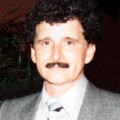
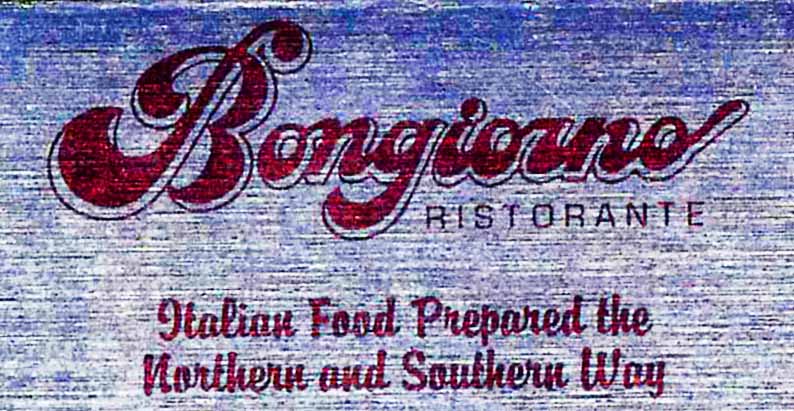
Unfortunately, Bongiorno spent too much time and money fixing the place up and the establishment was gone sometime after March 1983. Bongiorno passed away on October 27, 2012.
DUGGAN’S
In November 1983, William F. Duggan purchased the building from Northwest National Bank for $608,000. Bill Duggan was born on December 31, 1923, and grew up on a farm at 62nd and Highway 100 in Edina, which his parents sold and became a large subdivision in 1953. Duggan went to Park High in 1940, since Edina didn’t have a high school at the time, and was a friend of Jim Jennings. Ads for Duggan’s American Bar and Steakhouse began to appear in December 1983.
A restaurant review by the Tribune’s Karin Winegar reveals that Duggan was the silent backer whose partners were restaurateurs Robert Engel (his son-in-law) and David Ariz of Seattle. They had been scouting the demographics of the Twin Cities, looking for populations of well-heeled 25 to 50-year olds.
Trendy touches of the time were mesquite, neon, natural woodwork, ceiling fans, interesting wine, neo-healthy entrees, Italian salads, gelati, wine labels on the walls, framed photos of food, wicker, dried weeds in baskets, cane-backed chairs, earthtone wallpaper, Celestial Seasonings herbal teas, unsalted butter, and sparkling apple cider, reported Winegar. (April 22, 1984)
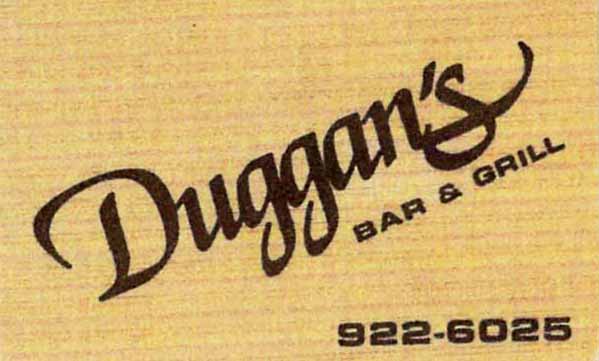
Willie’s Bar was declared open in December 1984. A photo of Mr. Shakespeare accompanied the announcement. A subsequent ad featured William Holden. A review by food critic Jeremy Iggers in 1988 reported that the restaurant was quite popular and the parking lot was full.
An ad/article from April 15, 1994, reveals that Bob Engel was the front man, while David Ariz was the chef. They moved here in 1982 from West Coast and Hawaiian restaurants. In the fall of 1994, a facelift was planned for the restaurant.
Duggan’s Boulevard Grill
Bill Duggan died on January 13, 1996, at the age of 72. At this point it may be that chef David Ariz became the sole owner. On December 1, 1996, an ad for Duggan’s Boulevard Grill appeared in the Minneapolis Tribune, promising a redesigned dining room and bar and advertising for all staff positions. The mascot for this new iteration of Duggan’s appears to be a dog serving a plate of spaghetti…
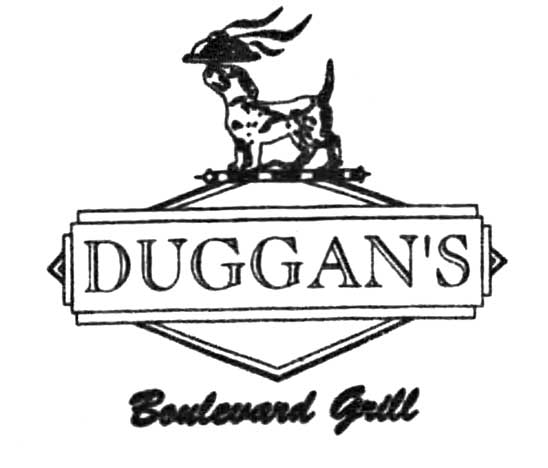
Minneapolis Tribune, June 26, 1997
On October 5, 1997, this very personal ad appeared in the wantads:
Yes I know. We’re looking for Cooks too. Isn’t everyone?? We pay the same as everyone, have the same equipment & wear the same outfits. Why work for us? We’re an independent w/the chef as the owner. He works like a dog all week and asks little of his co-workers. He enjoys a variety of music, has a weird sense of humor & enjoys Premium beer. He’ll improve your kitchen knowledge, remember your B-day and have an occasional brew with you. His name is Dave Ariz. (Minneapolis Tribune)
One of Duggan’s Boulevard Grill’s legacies was the outdoor patio, so popular now at Bunny’s.
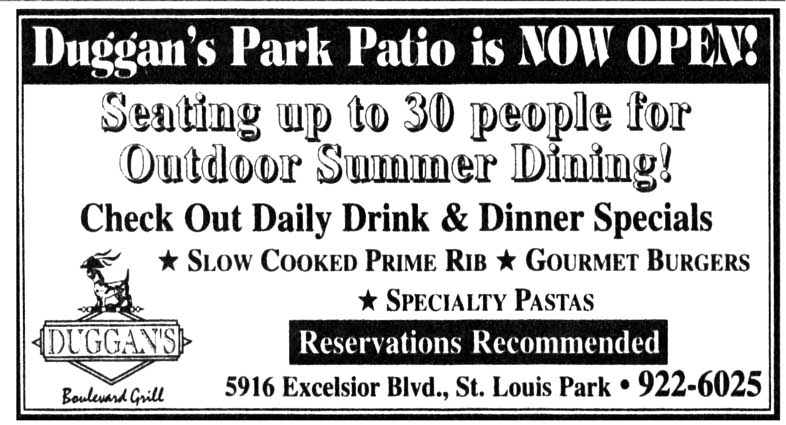
Minneapolis Tribune, June 12, 1998
Duggan’s Boulevard Grill closed on December 31, 1998.
BUNNY’S
Bunny’s was started in 1934 at 4730 Excelsior Blvd. That site had to be vacated by the end of 1998 to make way for Excelsior and Grand. In January 1999 owner Gary Rackner and his new business partner, Steve Koch, moved Bunny’s Bar and Grill to the old Duggan’s site. It was a great way to preserve both the business and the building. In honor of Sherman Rackner, Gary’s father and original business partner, the back bar was named “Sherm’s.” Despite the smoking ban enforced on bars by the Freedom to Breathe Act beginning on October 1, 2007, Bunny’s is thriving!
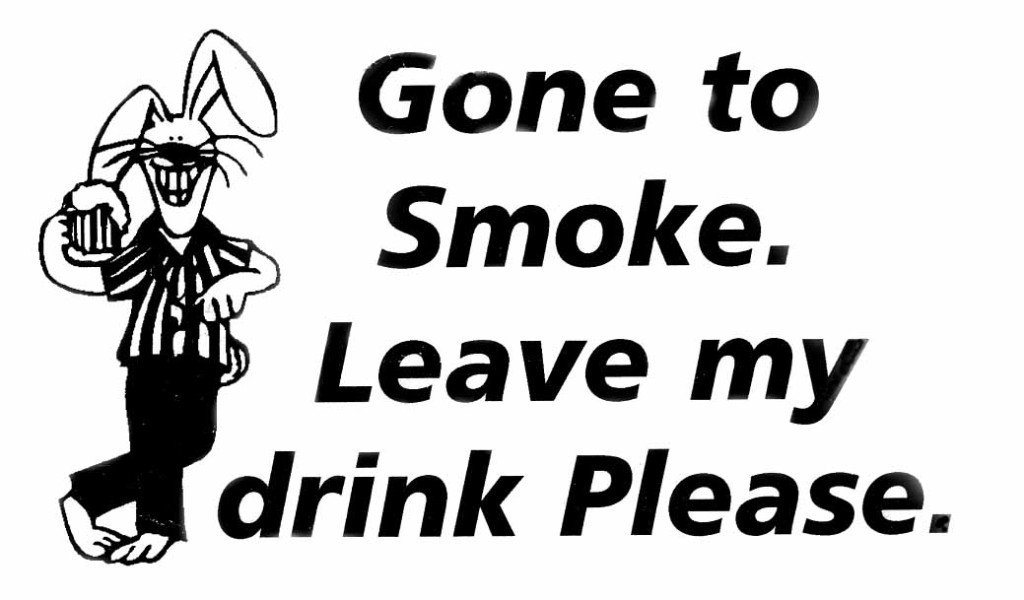
Ames Lodge, Number 106 of the Improved Benevolent and Protective Order of the Elks of the World, was formed in 1906 and incorporated on August 1, 1907. This was a black organization based on but completely separate from the IBPOE. It went by other names, such as the Elks’ Rest, Elks Lodge, and the Black Elks.
The Elks Lodge has been located in several places over the years.
KISTLER BUILDING
Ames Lodge No. 106, Order of Elks, Improved Benevolent Protective Order of Elks of the World. This Lodge of the IBPOE was founded in October 1906. From June 1 , 1921, to November 4, 1922, ads in the Northwest Bulletin referred to the third floor as the Elks Hall, and the Minnesota Daily Star referred to it as the Colored Elks Hall. Dances were held three times a week and on holidays. By June 11, 1924 to at least 1925 it was called the Ames Lodge or the Elks Hall.
Curry’s Jazz Orchestra provided music for dancing on April 21, 1922.
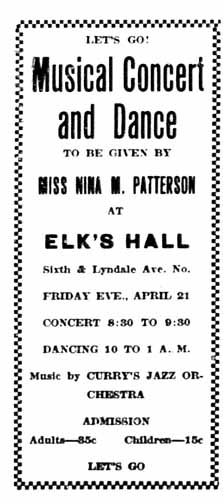
Northwest Bulletin, April 15, 1922
Bill Moore’s Jazz Orchestra led the dancers through the wild dances of the 1920s at this Emancipation Ball sponsored by a group called the Three Strutters.
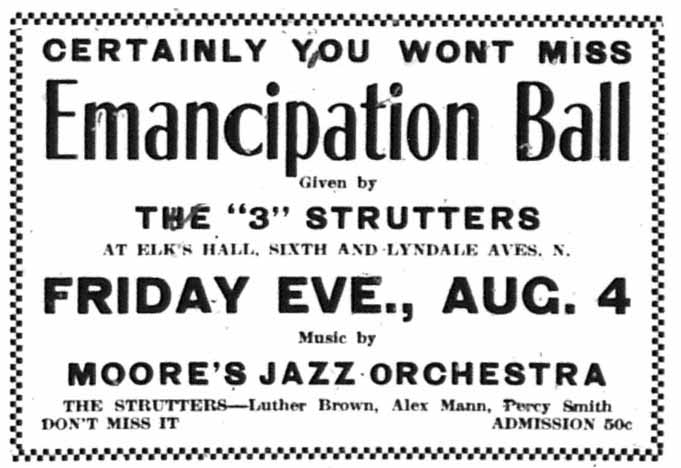
Northwest Bulletin, 1922
Bill Moore’s Jazz Orchestra was hugely popular in Minneapolis during these Roaring Twenties.
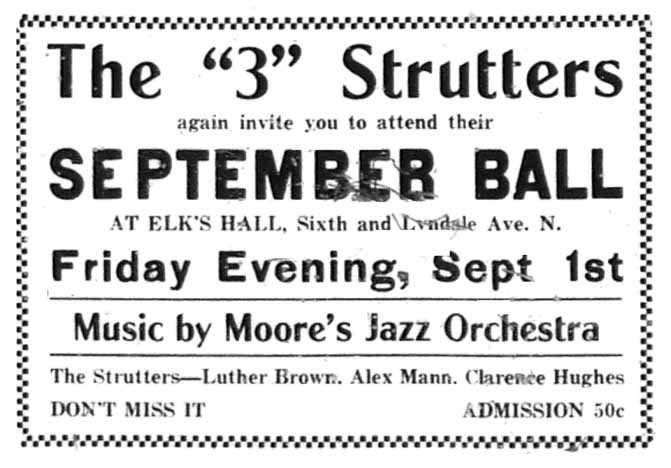
Northwest Bulletin, 1922
148 HIGHLAND
In about 1925, the Lodge moved to a large house at 148 Highland Ave., just off Sixth Ave. No. and Lyndale. The house was built in 1894 as a 17-room mansion on the edge of Oak Lake, which had since been filled in to become the municipal market. In March 1908, Dr. J.M. Kistler purchased “the Wilcox residence,” which was apparently run down, as he intended to make many repairs and live in the building. The purchase price was $7,500, well below the asking price of $9,000. The lot measured 150 feet on Highland Ave. and 150 feet on Lyndale.
Not long after the Lodge moved in in 1922, in June 1924, J.W. Moore applied for a dance hall license for the Ritz Cafe at 148 Highland, despite the protests of a local rabbi the month before. The rabbi was back in June, but was told that the police had closed the cafe for violation of the closing time ordinance and because the customers were noisy. (Minneapolis Tribune, June 4, 1924)
On April 18, 1933, just 11 days after it was legal, the Ames Lodge received a liquor license.
It was a black and tan music venue from at least 1934 to the late 1940s. Dances were held every Saturday night. Between bands Mrs. Meade would play piano.
In 1937 Ernest Saunders was the proprietor of the Elks Cafe in the building. An April 1937 article in the Minneapolis Spokesman said that J.W. Hutchcraft was the manager, replacing Edward L. Boyd. The article noted, “Hutchcraft is unusual in that it is impossible to tell whether he is Caucasian or Negro.”
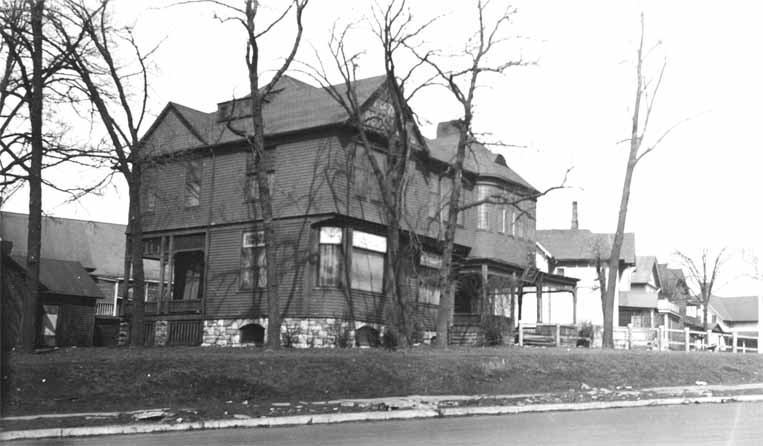
Photo taken March 29, 1937, courtesy Hennepin County Library, via Alan Slacter
Apparently one could either live at the building or stay for a night, presuming that you were an Elk.
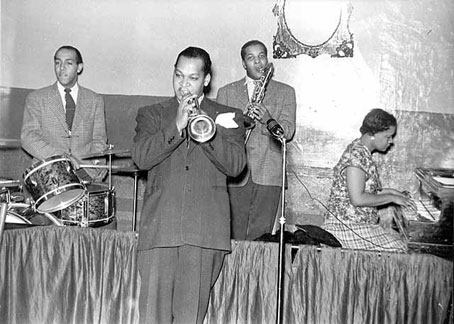
Entertainment at the Ames Lodge, 1950. Photo courtesy Minnesota Historical Society
The Ames Lodge Drum and Bugle Corps was a consistent crowd pleaser in Aquatennial and Winter Carnival parades, with their unique marching style and musicality. In the summer of 1951 they won the Grand Award in music and marching units at the Torchlight parade.
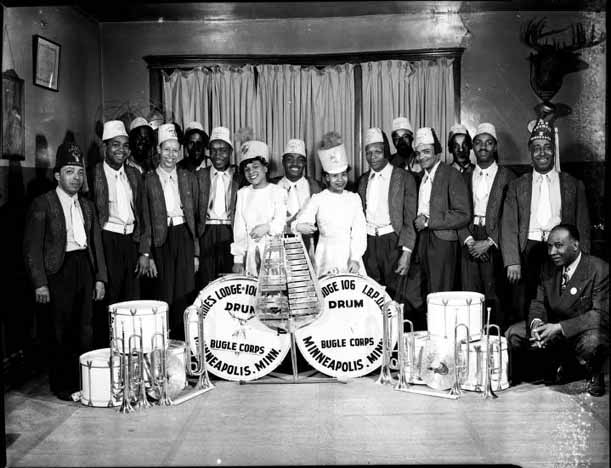
Drum & Bugle Corps, 1940s. Courtesy Hennepin County Library and the Children of John Glanton
In 1953 it was revealed by an undercover policeman that the Elks’ Rest was a transfer point for the delivery of heroin in the City. (Minneapolis Star, May 5, 1953)
148 Highland was torn down in April 1957 as part of the Glenwood Redevelopment Project.
1215 ALDRICH AVE NO.
The Elks relocated to another house at 1215 Aldrich Ave. No. That building was built in 1887 and was removed for highway construction in 1969.
1614 PLYMOUTH AVE. NO.
On July 7, 1968, ground was broken for the first new building on Plymouth Ave. since the $23 Million Near Northside Urban Renewal Program got underway the previous month. The Lodge building at 1614 Plymouth Ave. was expected to cost $38,000, and was being financed by First National Bank.
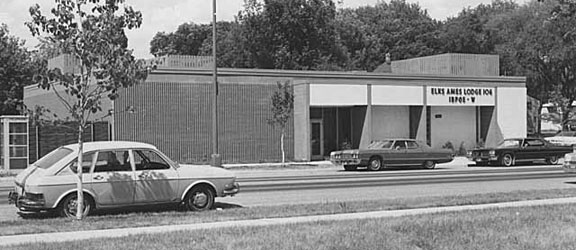
July 17, 1975 photo courtesy Minnesota Historical Society
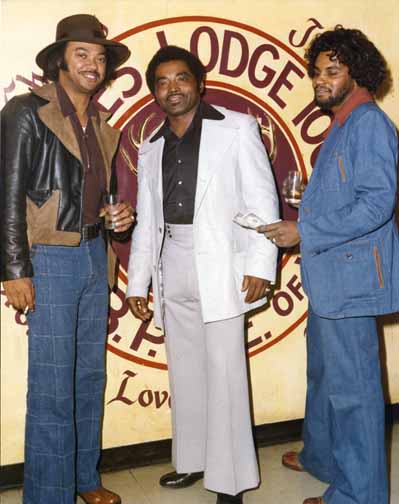
Photo by Charles Chambliss, courtesy Hennepin County Library – @ 1975 to 1985
As of August 2021, the Secretary of State’s website says that the status of the organization is “involuntarily inactive” as of early 2021, but that can be reversed.
Unbelievable luck led me to find the photo of the Ames Lodge fez online!
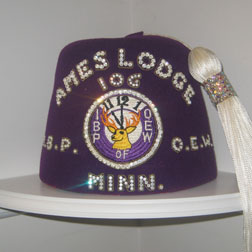

Elsen’s Inn was at the corner of Bass Lake Road and Jefferson Highway from 1940-44 and was advertised in the Polish American and the Republican Register. “A Good Place to Eat and Be Merry,” “Dance Floor in Connection.”
The Embassy Club was a tavern/roadhouse/supper club/restaurant, way outside the city lines, but close enough to the ‘Cities to advertise in the Minneapolis papers.
LOCATION
The Embassy was located in Burnsville, when there was no Burnsville. It was on Highway 35W when there was no 35W. Most early advertising just described it as Lyndale Ave. So. and Minnesota River Blvd. Even now, the location is described as Highway 35 W and 122 Street. An alternate address is 11981 Embassy Road. Or, you could say it is gone.
Karen Anderson helped me out with the location:
Whenever the river flooded, the building was in danger of flooding. It wasn’t in the best location. I would have thought it was rather hard to get to, as well. The photo from Google Maps, showing the building, was taken in 2011. If you ‘drive’ down the road a little farther, the scene changes to a winter scene and the building is gone. It was taken in 2022. According to Google Maps, The Embassy was on Embassy Road. It was on the west side of 35W, just north of Cliff Road. It was in approximately the spot where I put the X on the map.
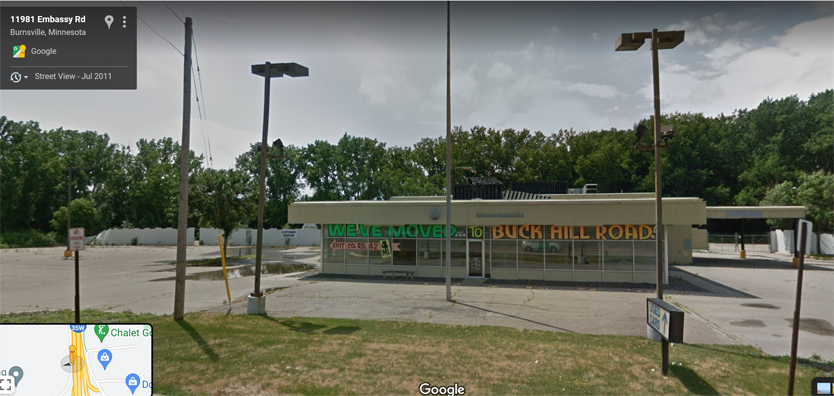
The Embassy, with parking lot et al. Google image courtesy Karen Andersen
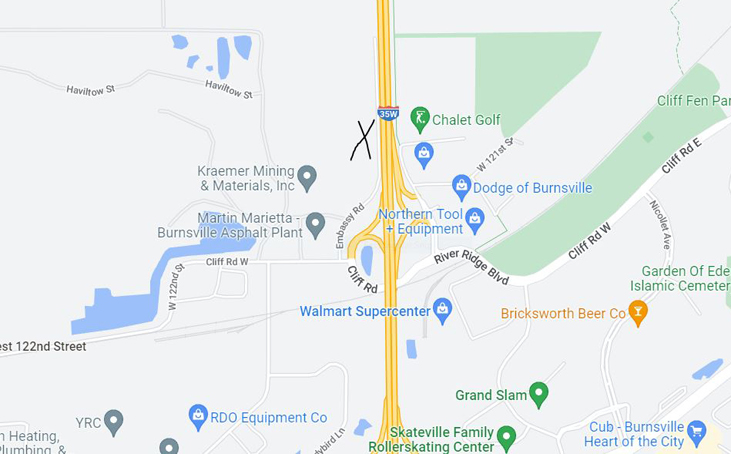
Location of the Embassy marked by Karen Anderson
HISTORY OF THE EMBASSY
When Karen sent this to me, I had almost nothing on this out-of-the-way place, except for some ads from 1933 and 1935. This couldn’t be the same place, could it? But I did a newspaper search, and it appears that the Embassy very well may have been in its location since 1928! Bring your own liquor, of course. Eventually it had the only liquor license in Dakota County.
more to come
Dancing to the Bobby Bird Trio, 1969.
823 University Ave., St. Paul – Country bar in 1973.
Please See Foshay Tower.
This page is about some of the music venues around the turn of the last century in the Excelsior area, on the shore of Lake Minnetonka. The information comes from the book Excelsior’s Waterfront: The History of the Excelsior Commons and Excelsior Docks, written by Scott D. McGinnis (2008). Many thanks to Scott for going through this material with me to clarify all the different venues. His extraordinarily well-researched book is available for $10 at the Excelsior-Lake Minnetonka Historical Society.
NOTE: This page does not include the predecessor to the Ballroom at Excelsior Amusement Park; that information is on the Danceland page.
LAKE MINNETONKA CASINO
The Lake Minnetonka Casino was built on the Docks at the foot of Water Street. This was not a gambling casino, but an entertainment center where people could go for bowling, roller skating, refreshments, dining, boat rental, and to buy sundries and bait, etc.
The $12,000 building was located on lakeshore in front of the Hotel LaPaul (later known as the Excelsior Bay Hotel), leased from the LaPaul family. One of the largest pavilions in Excelsior, it included a six lane bowling alley, billiard parlors, something called Box Ball, and a 60 x 135 ballroom. No intoxicating beverages were allowed. The Grand Opening was held on June 6, 1903. The Casino Orchestra, led by Carl Reidelsberger, provided music every afternoon and evening.
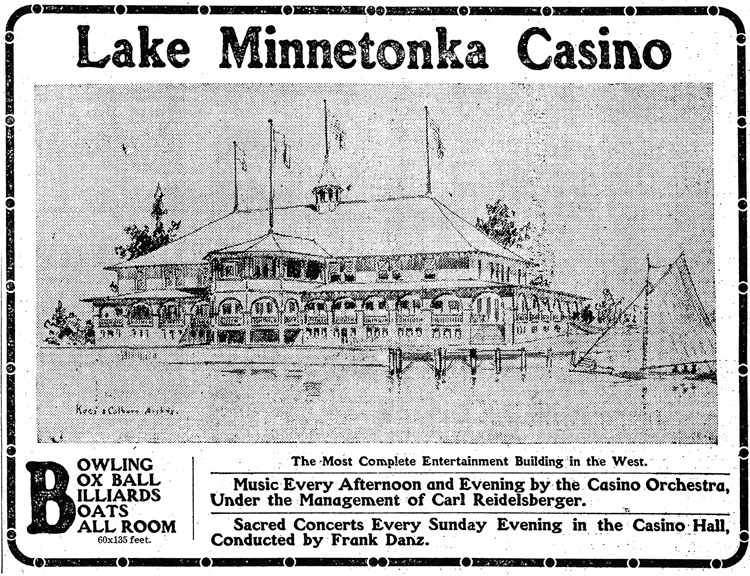
Minneapolis Journal, June 6, 1903
On May 8, 1920, there was an ad for the first dance of the season at the Casino in Excelsior. Music by Squires’ Orchestra; tickets were $1 per Couple. Extra Lady 25 cents. The Casino pavilion was doing a thriving weekend business as well as Saturday night hops (May 28, 1920).
In 1918, Richard and Ruby Golden purchased the Hotel LaPaul and renamed it the Excelsior Bay Hotel. The Goldens, like the LaPauls, felt that the Casino cut into their business at their hotel, and threatened to hold them to their lease, which required the Casino to be removed by January 1, 1923. To forestall this, the Excelsior Park Board made efforts to purchase the property, and the Minnetonka Record reported that the Village had done so, but according to Scott McGinnis’s exacting research, the transaction was never completed.
On December 15, 1922: “The Excelsior Casino, which was built in 1902, will soon be no more. A wrecking crew started work on it this week and the building will be razed to the ground. The work is in charge of Elmer Carlson and Oskar Carlson.”
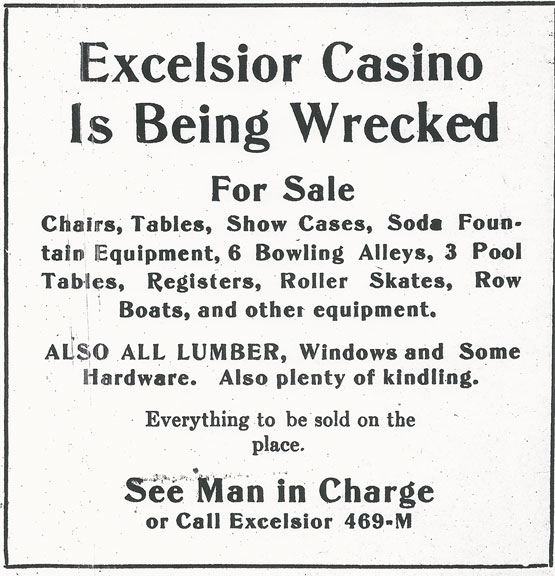
Minnetonka Record, December 22, 1922
The Casino was dismantled and the lumber was used to build a summer cabin up north. The Excelsior Band’s bandstand was moved onto part of the property in April 1923.
In July 1923 it was reported that the water in front of the old casino site was being being dredged and the depression where the casino was was being filled in. “A small mountain of black mud has been thrown up where the casino stood. It is being graded down by the Park Board and will be seeded. A fine green park will be made, extending to the water’s edge, at the foot of Water Street. When completed, it will be a miniature Batteray (sic).” (July 6, 1923)
In about 1938 the bandstand was moved closer to the shore and became the Lakeview Hasty-Tasty Hamburger Stand.
EXCELSIOR COMMONS PAVILION
This building was built by the Excelsior Park Board at the end of the 1923 season to replace the Lake Minnetonka Casino. It was located “on the knoll at the east end of the Commons overlooking the lake. It is a part of the Commons that has not been used regularly. The architecture will be simple and in keeping with the surroundings.” Construction was started in July 1923, by the J.C. Weinholz Construction Co. Of the $9,400 cost, only $1,762 was actually paid to the contractor, even after several lawsuits were filed.
The pavilion measured 40 x 80, and the dance floor was “large enough to accommodate several hundred couples at a time.”
An ad from May 1926 announced the opening of the Excelsior Commons Pavilion Skating Rink, featuring New Skates and Good Music. The proprietor/manager was Walter G. Nelson.
In 1927, it appeared that J.E. McNiece was the proprietor, according to an ad dated June 3, which offered roller skating on Wednesdays, Saturdays, and Sundays.
In 1928 the manager, Eddie Maynard, installed an Orthophonic (amplification device) in the building and opened it for roller skating every evening and Sunday afternoons.
The Excelsior Commons Pavilion only lasted ten years – in February 1933 the Excelsior Fire Marshal ordered it repaired or demolished. The Park Board sold it to L. Mann for $125 it was demolished.
EXCELSIOR BATH HOUSE
The first known commercial Bath House was built in 1879 by Freeman G. Gould. It was located on the Commons and included a restaurant. It was 60 feet long and had 12 changing rooms. Gould also rented boats, and in 1881 he began a ferry service between the bath house to the Lake Park Hotel across Gideon’s Bay.
In 1882 Frank L. Perkins took over the lease and installed a dance floor that was expanded to 32 x 28 in 1884. Dances were not allowed on Sundays.
By 1890 the lease holders were Willard E and Louis D Perkins, and among the amenities of the Bath House was a 40 x 70 dancing platform.
John Thurston leased the Commons Bath House from 1902 to 1910. The Village took over management until about 1946.
STETSON’S BLUE LINE PAVILION
This building was originally built by Llewellyn B. Stetson in 1882 – no music is noted. Stetson had previously operated his Blue Line Boat Company on the western shore of Cedar Lake in Minneapolis. It was proximate to the Stetson House, a hotel that Stetson and his brother George built in 1885.
By 1890 the pavilion was owned by Frank L. Perkins and Walter Baker. Perkins asked Stetson, an architect, for assistance in redesigning the building. The old pavilion and dock were demolished and the new pavilion included a 40 x 70 dance floor.
In 1903/1904 the pavilion was moved down the shore; a newspaper article from May 1904 described it as “rebuilt.” In 1920 the managers were Joos and Francis; an update on the season’s business does not mention dancing at the Blue Line.
The building became the New Blue Line Cafe and was placed on the Amusement Park grounds in May 1938.
The Blue Line Cafe burned down on March 4, 1958.
MORSE DANCE HALL AND BILLIARD HALL
This two-story building was built in July 1876 by William B. Morse, an early area settler and the original owner of Big Island. The building had two stories, and the second floor had a 24 x 30 dance floor. It was a popular Saturday night dancing venue for young folks around the lake. However, Morse had a penchant for serving liquor to minors, being arrested three times in 1890. Then he got in trouble for encroaching on Lake Street, and he apparent had to move his entire building back from the street. The business lasted until about 1906.
MOTOR LINE PAVILION
Colonel William McCrory extended his narrow-gauge Minneapolis, Lyndale, and Minnetonka Railway, known as the “Motor Line,” to Excelsior in 1882. The Railway built a large pier from its tracks into Lake Minnetonka, and in 1886 it contracted with Orpheus S. Gates to build a pavilion on the pier to accommodate train and steamboat passengers. Gates built the new pavilion at the foot of Water Street, adjacent to the Gates and Dunlap Pavilion he had built in 1874. The pavilion was 28 x 100, with two stories. “The upper floor is curtained, forming a popular place for dances, concerts and other entertainments.” (Saturday Evening Spectator, August 1886)
The tracks were purchased by the Minneapolis, St. Paul, and Manitoba Railway in 1887, but due to a number of factors the use of the railway was reduced and the line into Excelsior was abandoned. Gates died in 1887, and the pavilion became the property of Captain Charles May. He lost the line and the pavilion in a property dispute and the pavilion became an eyesore. It was removed in April 1891.
TONKA BAY/FINK’S PAVILION
Some of this is based on speculation, but I think it goes something like this:
The building’s contemporary address is 110 Sunrise Ave., Tonka Bay, Lake Minnetonka.
When was it built?
- County records indicate that it was built in 1900.
- Mr. Fink’s obituary indicates that he owned it starting in 1898.
- If it is the Tonka Bay Pavilion found in the Minneapolis papers, it goes back to 1899.
[Placeholder: An ad from
TONKA BAY PAVILION
A couple of items in July and August 1899 mention a dance and a banquet, both using the Bijou Orchestra.
When the Beach Pavilion opened in 1904, references to the “Tonka Bay pavilion” were probably referring to the new Beach Pavilion. However, one ad for a dance at the Beach Pavilion made a special note that a different dance was being held at the “old” Tonka Bay Pavilion.

June 18, 1904
FINK’S PAVILION
The obituary of Ferdinand J. Fink says that he was the operator of Curley’s Resort from 1898 to 1935. There are references to Fink’s Pavilion, mostly a site for picnics, in the Minneapolis papers from 1910 to August 29, 1936.
Where was Fink’s? The last reference places it two blocks from Priebe’s Resort. So where was Priebe’s? It appears that it was “across from the roller rink” in 1911. In 1916 it was one block from the end of the Tonka Bay streetcar. Minnie Priebe apparently never actually lived in Minnetonka, but in Minneapolis, where her husband Heinrich “Henry” J. Priebe was a fireman. Although a notice in 1916 said that the place (also known as the Lakeview Inn) was under new management (J.J. Frink), Minnie was still listed in an ad in 1918.) But I digress.
Ferdinand Fink was a Village leader, serving several years as constable. In May 1899 he was appointed postmaster of the new Village. In 1901 he was the caretaker of the Lake Park Hotel, which burned down under suspicious circumstances.
An item dated June 8, 1923, says that Fink was granted a permit to build another dance hall on the beach, but he met with resistance from the community, so it is unclear whether it was actually built.
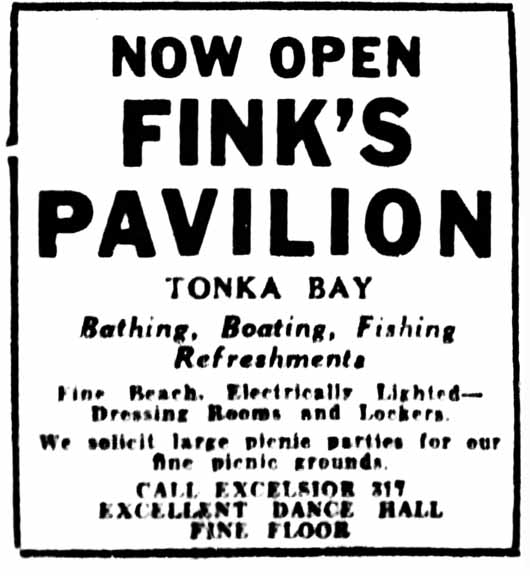
May 27, 1932
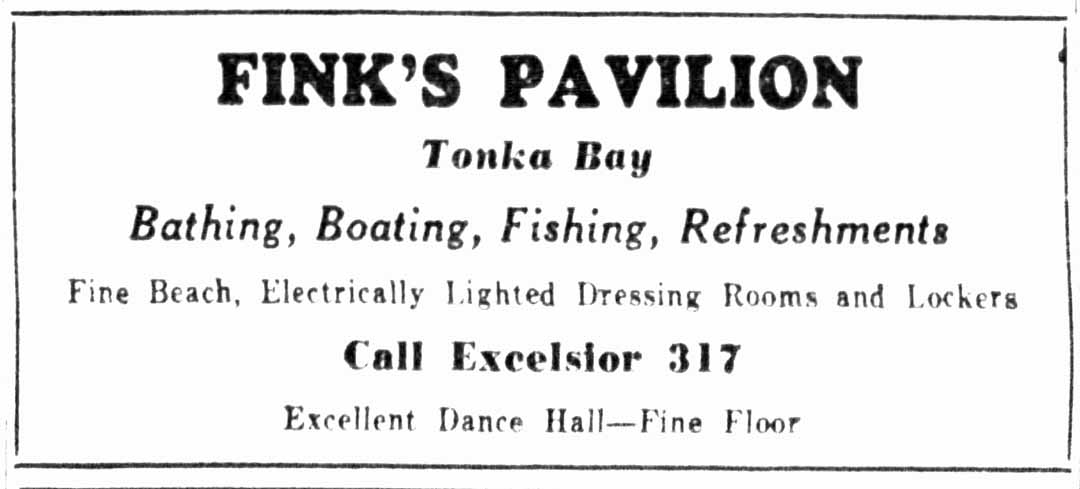
June 16, 1935
TONKA BAY PAVILION
The ad below indicates that Fink’s Pavilion became the Tonka Bay Pavilion in 1936, and that Percy Villa and Sammy Levine were the new owners. A subsequent item indicates that it was located 2 1/2 miles from Excelsior.
In 1939 the manager was LeRoy Johnson. There doesn’t seem to be any indication that it was being used as a dance hall, but there are very few ads in the Minneapolis papers.
In 1950 we learn that the owner had been C. A. Thompson, who sold the Pavilion and bought the Jackson Cafe at Jackson’s Corner, Navarre.
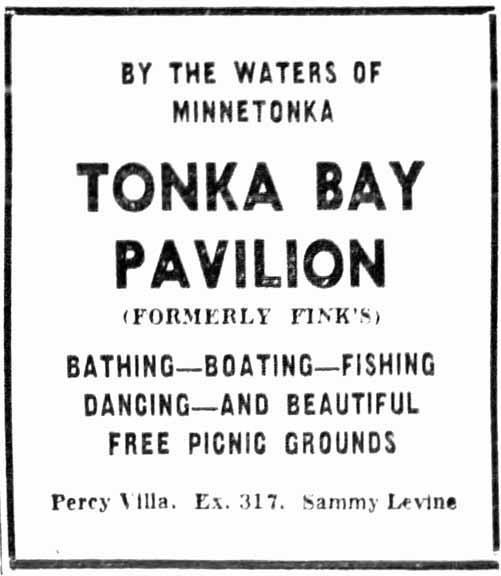
May 27, 1936
County records indicate that 110 Sunrise Drive, built in 1900, is now a privately-owned home.
Thank you to Alan Slacter and the folks on Facebook for their help with this complicated venue!
This is the story of 329 Cedar Ave. So. in the Cedar-Riverside area on the West Bank, by the University of Minnesota. It’s unusual that a building has held so many different music venues. This one has hosted:
- Chuck’s Skol Club
- The Alibi Club
- The Excuse Club
- The New Riverside Cafe
- The Acadia Cafe
LARSEN’S SALOON
This property is listed as 329 – 331 Cedar Ave. in the City’s records. It goes back to 1898 when it cost $8,000 to build a 22 x 60 brick store building. The City’s permit cards mention both a saloon and a store, and it’s difficult to tell whether they are talking about the same address or two different addresses. Nels M. Nordeen obtained a liquor license in 1899; Nels Benson was the proprietor when the saloon was robbed in 1906. From at least 1909 to 1919, the proprietor was Albert Theodore Larsen (1869 – 1951). The bar was owned by the Minneapolis Brewing Company, which made Golden Grain Belt Beer. Jeff Lonto explains:
Before Prohibition (1920-1933) breweries owned their own saloons, called “tied houses” that exclusively served their products. The practice was banned after Repeal. Minneapolis Brewing Company officially changed its name to Grain Belt Breweries, Inc. in May 1967.
Below is a photo of the saloon from 1919. Unfortunately, there doesn’t seem to be a name on it other than all the Grain Belt signs. Thanks to Alan Slacter for finding the photo!
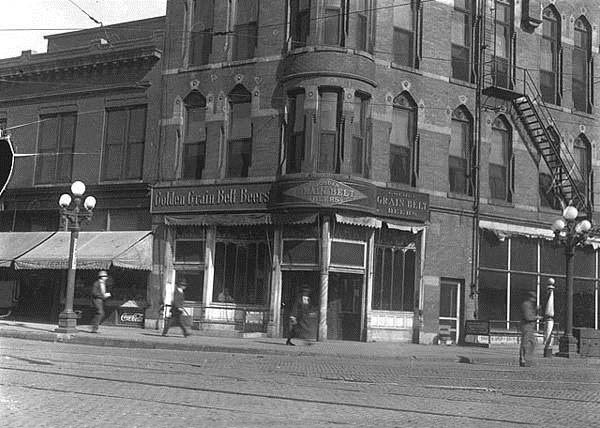
327 Cedar Ave. Photo courtesy Minnesota Historical Society
HALL
There was also some kind of hall in the building; a notation in 1904 on the permit card mentions “store and hall,” and in 1907 there was a club room used by the South Side Commercial Club. The word “club” is used again in 1923, and in 1934 the newspaper mentions a CWA Workers Organization and a Steel and Metal Workers Hall. The building was also used as a “concentration point” for the Trucker’s Strike of 1934. Whether this hall was on the second or third floor is unknown.
PROHIBITION AND BEYOND
In 1920 the 20-year-old saloon had to close its doors, and it appears that it became a National Tea Grocery Store until 1934. Unfortunately, there was a fire in January 1921, causing $2,000 damage, but repairs were made. Various meat markets advertised that operated inside the store.
Come 1934 and liquor flowed again – Louise Rouse leased the building for the King Cole Liquor Store, but got in trouble when she sold liquor to a 17-year-old who got drunk and went out and stole cars. The license was transferred and the store remained until 1940.
In 1941 we see the Blue Goose Cafe, and not the one up north where the gangsters hung out. This one operated from about November 1941 to 1950, although the building was still a restaurant in 1954, so the Blue Goose might have lasted longer.
Note that the third floor was removed in January 1946, at a cost of $1,000 for demolition and $2,000 for alterations to the building. This action does not seem to be a result of a fire or other catastrophe that I could find.
On December 23, 1953, there was another fire in the building, but Trixie the dog managed to wake up all the sleeping tenants. But then some miscreant broke into a fire damaged door and ransacked the cafe. Repairs in March 1954 cost $12,000; more repairs in July took another $2,000.
CHUCK’S SKOL CLUB
329 wasn’t the only building having fires. 326 burned down completely, leaving the Klondike Club in the lurch. It moved across the street into the newly refurbished building, and was renamed Chuck’s Skol Club. Chuck who, I don’t know. The first ad appeared on September 21, 1955.
Janet Charles had been the star over at the Klondike Club; Will Jones called her “The Girl who Tamed Cedar Avenue.” Her schtick was to dance on the bar, which could be hazardous, especially when mean women poured beer on it to make it slippery. She moved her act over to Chuck’s when the Klondike closed.
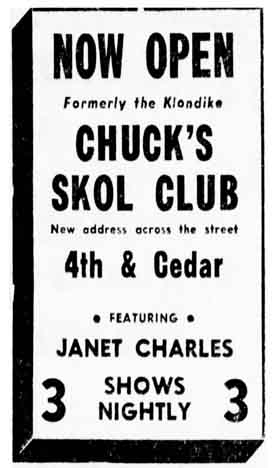
Minneapolis Tribune, September 21, 1955
Janet got her wish to do her Bubble Bath routine, which she copied from Lili St. Cyr, at Chuck’s. The Klondike wouldn’t accommodate her need for water.
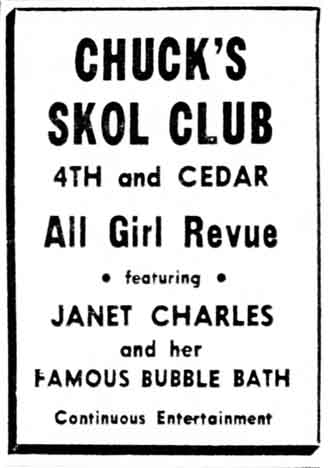
Minneapolis Tribune, July 19, 1956
Below is the final ad for Chuck’s I could find in the Minneapolis papers. The “re-opens” refers to a 10-day suspension the club received when a waitress was caught serving a customer after hours.
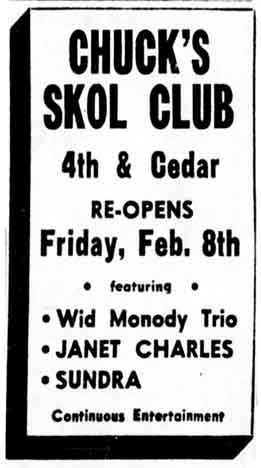
Minneapolis Tribune, February 9, 1957
ALIBI CLUB
By August 1958, 329 had become the Alibi Club – basically a strip joint. When the Twins came to town in 1961 the head stripper added a baseball number to her act, reported Will Jones. Leering allowed.
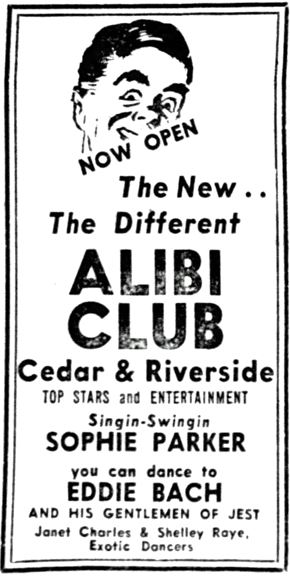
Minneapolis Star, August 8, 1958
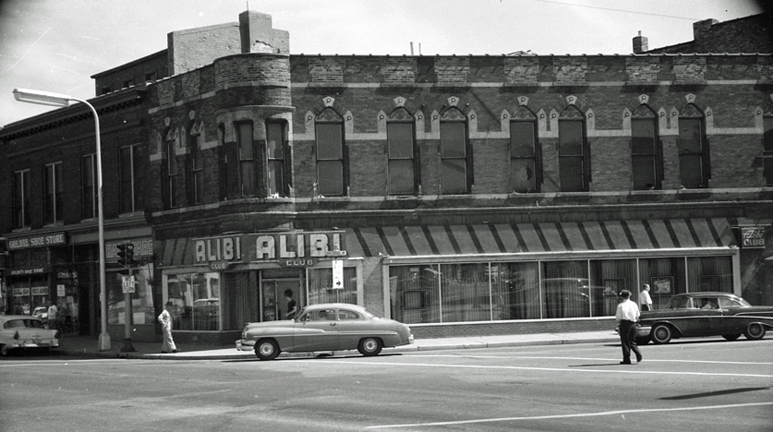
1960 photo courtesy Hennepin County Library
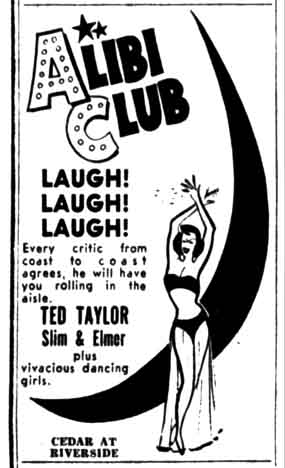
Minneapolis Star, November 11, 1960
The Alibi Club’s liquor license was purchased by the Black Sheep Club, which moved to 901 Marquette Ave. in November 1961. That’s when the Alibi Club closed.
WALTER’S BAR
Walter Holmes was mentioned as the proprietor of the place in October 1963. In April 1964, a Kenneth King wanted to take over the liquor license, but was denied because the place was too close to the U of M and was being frequented by minors. Walter’s name was listed as Walter R. Home.
EXCUSE CLUB
By December 1964, 329 Cedar had become the Excuse Club, presenting Country/Western entertainment until about July 1967. I’m so excited to see this photo!
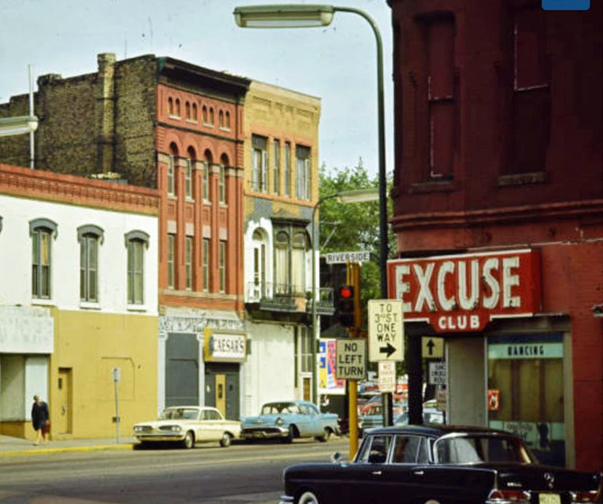
Photo courtesy Hennepin County Library
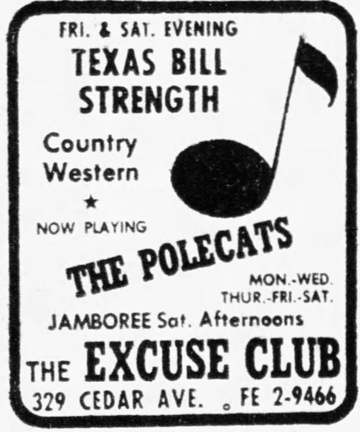
Minneapolis Star, October 7, 1965
NEW RIVERSIDE CAFE
The New Riverside Cafe moved in in late 1971 and closed on May 10, 1997.
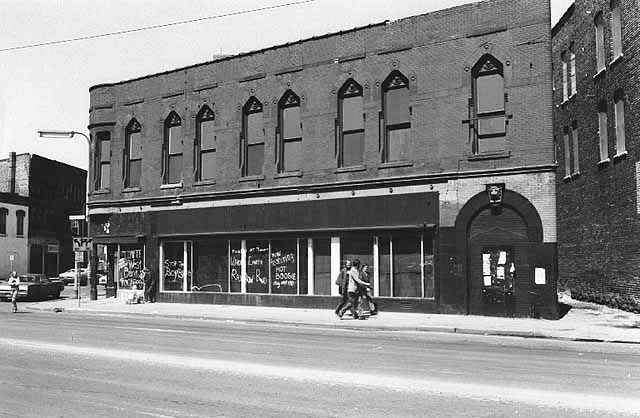
329 Cedar Ave., 1972. Courtesy Minnesota Historical Society
AND THE LIST GOES ON
For some reason the location had a string of bad luck, with several restaurants that came and went:
- Cafe Bellaluna, April 1998
- Emerald Cafe, Summer 1998
- Grey Duck, September 1999
- Falafel King, August 2000
ACADIA CAFE
As of 2009 the building has hosted the Acadia Cafe, which is also a music venue.
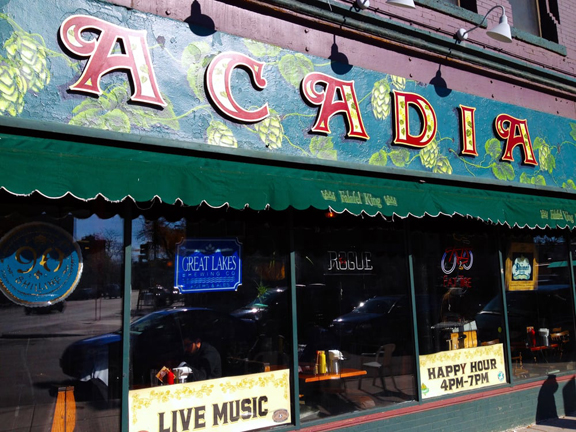
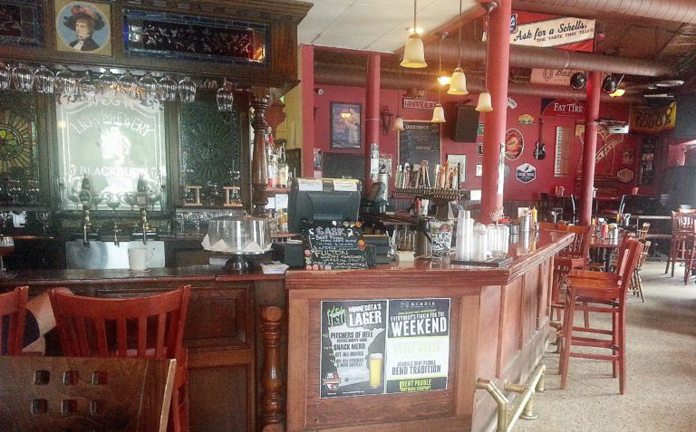
On Tuesday, March 15, 2022, a University of Minnesota commuter shuttle crashed into the Acadia Cafe. Fortunately, only a line cook and bartender were inside, and neither was hurt. Also uninjured were the bus driver and the sole passenger. The restaurant was closed indefinitely and a GoFundMe was set up to compensate workers until it could open again.
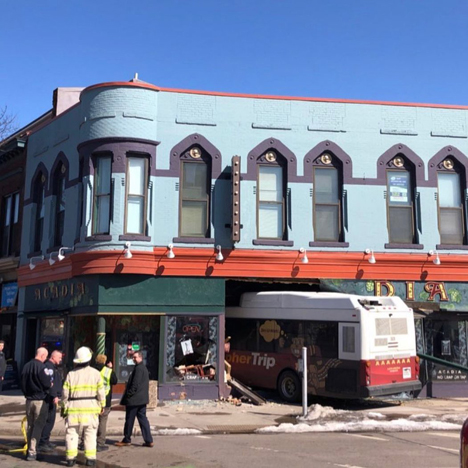
Exposition Hall was built in 1886 and was used almost entirely for concerts, according to Edgar.
The Factory was on University Ave. across from the Prom Ballroom in St. Paul, 1968-69.
As of 2015-17 (at least) it’s been Arnellia’s.
Feifarek Nite Club, run by Harry Feifarek, was in Red Rock from at least April 1943 to February 1944. Where was Red Rock? A tiny township in Mower County? Advertised in the Republican Register.
FERRARA’S
Ferrara’s was opened in August of 1962 at 501 East Hennepin by Louis, James, and Maria Ferrara, who had run the East Hennepin Cafe next door. The county shows the year built as 1960; since the address of the East Hennepin Cafe was 507 E. Hennepin, it is possible that in 1960 the Ferraras bought the corner building and the property was reconfigured at that time.
Don Morrison described the new Ferrara’s in his column on August 31, 1962:
There obviously was no stinting of money in creating the new place. It has a stylish-looking cocktail lounge immediately off the street, through which one reaches the Organ Grinder piano bar at the rear. The latter grabs you immediately with its nicety of detail – an imaginative Neapolitan motif that could have been overly cute, but which, instead, is bright and witty.
Quality touches are everywhere. There is a mural of Italian street types that will be looked at often and studied closely. in the bar and cocktail tables are inset bottom-lighted fruit designs “painted” with chips of colored glass.
The split-level dining room makes you gasp at first glimpse. The entire ceiling simulates a huge arbor with outsized bunches of stylized grapes dangling down. An old wine press has a spigot from which individual glasses of table vino will be served.
It is a place that makes a calculated assault upon your senses, but the effect is a happy one. With so much slick sameness around, it is fun to enter a spot that commands your attention and makes you realize you are some place.
The design is by Allan F. Svensson, who also did such distinctive new places as Freddie’s, the Ambassador, Diamond Jim’s, the Black Angus and the soon-to-open 211 Club at the Hastings Hotel.
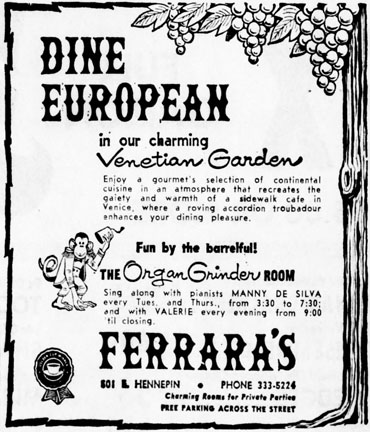
Minneapolis Star, January 31, 1963
1963-69: Manny De Silva played in the piano lounge.
July 1968: Frankie Cammarata on the Hammond in the Dining Room.
In 1968 the Cafe provided free bus service to Gopher football games.
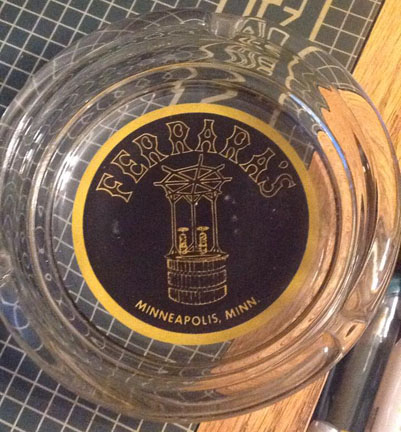
Image courtesy Mark Youngblood
1969: John Skelly was the organist in the dining room.
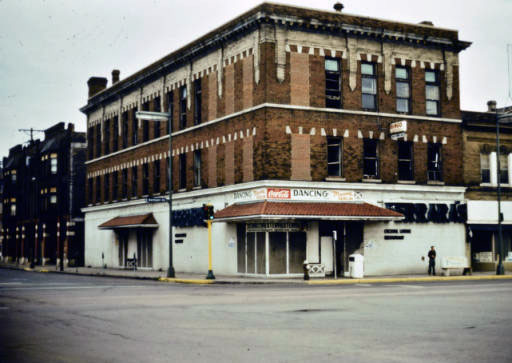
Courtesy Hennepin County Library
In the early hours of January 1, 1970, there was a fire at Ferrara’s, and the building was reduced to one story.
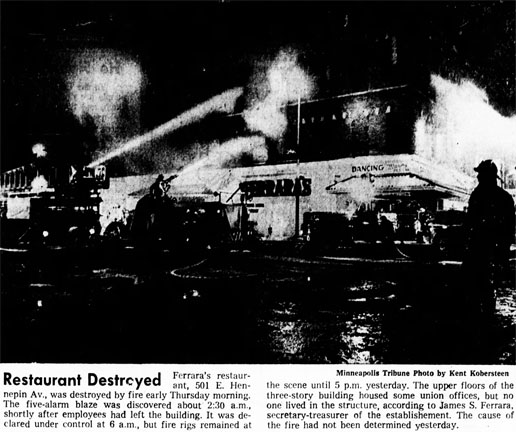
Minneapolis Tribune, January 2, 1970
The first floor was salvaged and is now Conga Latin Bistro.
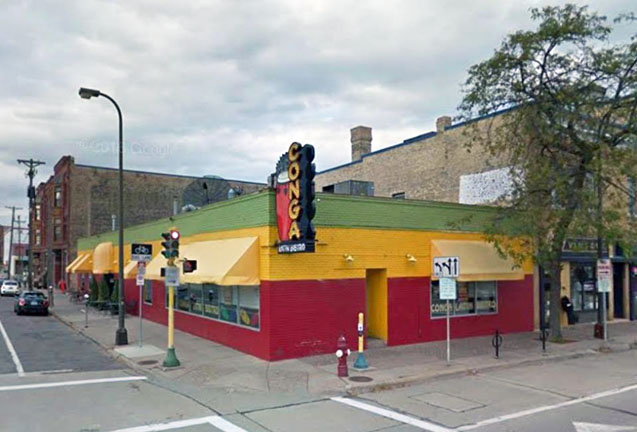
Google Street View
Tonka Bay, August 1931.
Fiorito’s Drinking Emporium was located in the Park Square Building, 400 Sibley Street, in St. Paul. The Park Square Building was an old manufacturing plant, turned into a venue for small businesses.
Fiorito’s was owned by Stanley Fiorito, Jr., in or before December 1972. Barbara Flanigan wrote in her column that the Fiorito family had been in the bar and restaurant business since 1900. Also, the walls of the place were covered with the pages of old St. Paul newspapers. (Minneapolis Star, December 14, 1972)
A search reveals a Joe Fiorito, who played accordion on KSTP radio, and a Ted Fiorito, whose orchestra was heard on the radio and on movie soundtracks.
At first, on May 3, 1973, Will Jones of the Minneapolis Tribune reported that at night they brought in a rock band and the place filled up like a packed madhouse. He did like their 90 cent martinis, though.
Then on May 28, 1973, Jones had to make a correction and clarify that the house band was just two people, known collectively as the Smith Park Spring Ensemble:
- Bill Gay on tenor and five-string banjo, and
- Tom Mega on string bass and acoustic guitar
They did, however, admit to playing to a packed madhouse, with people singing along to songs like “Waitin’ for the Robert E. Lee,” “Swanee,” and “The William Tell Overture.” People would do the hora or dance on the table tops, they said. Must be those 90 cent martinis…
The Ensemble was to be replaced in a week for a banjo and tuba duo, playing similar music.
An article from December 3, 1973, says that a banjo band performed Thursday through Saturday nights and the audience often sang along. (Minneapolis Tribune)
JAZZ
By August 1974, Wednesday and Thursday nights at Fiorito’s became jazz nights, reported Will Jones.
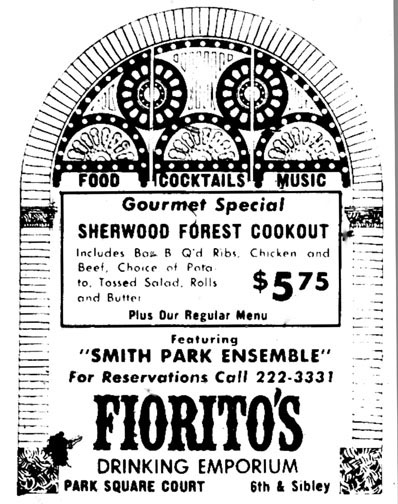
St. Paul Pioneer Press, June 8, 1974
In December 1977 to July 1978, the Mouldy Figs Dixieland Jazz Band was advertised.
The Fire Barn was on 38th St. just west of Minnehaha Ave. [38th and Snelling?] in Minneapolis. Billy Hallquist told this story:
Winter of ’65/’66. Bitter cold. The Transgressors are playing at The Fire Barn. One of the evening’s highlights will be our debut performance of “Play with Fire” by the Rolling Stones. Al Sterner is going to go beyond his rhythm guitar duties and play the song’s introduction. He looks forward to bathing in the spotlight that all of us “lead” guitarists experience every gig. We inform Al that his moment will lead off the second set. We all stand back allowing Al to stand front and center. Al turns up his Fender Jazzmaster to maximum volume and history is made. Oops. Did I forget to mention that while we were on break, Leon, Bob or I had secretly turned the tuning pegs on his guitar in random and opposing directions. Al, being quite nervous about his moment in the sun, plays practically the entire intro before realizing something is dreadfully wrong.
The Fireside was a Country Western venue in Fridley in 1959 – 1960.
Performers included Jimmy Wells and His Dakota Roundup Gang.
Ardis Wells was featured during an hour broadcast over KEVE on Sundays at 4 pm.
Please see the Depot, Uncle Sam’s, and Sam’s.
Please see More Down Stairs.
501 So. Cedar Ave., West Bank, Minneapolis.
FIVE CORNERS SALOON
In 1905 there was a Five Corners Saloon at 337 Fifth Street NE. In 1914 a butcher shop in the same area was identified as Five Corners.
In February 1936 the owners of the Five Corners Bar at 501 Cedar were John A. Foss and John Vooge. It was the first notice I found of a liquor license.
In April 1938 it was called the Five Corners Cafe.
In September 1963 the owner was Art Leow. There were plenty of news reports of robberies at the place.
An article in the Tribune in February 1964 described the clientele at the bar as “almost exclusively older people.” The bartender said that most of them sit there all day and that the bar was kind of a social club for them.
Pictured below are Willie and the Bees, 1966. Photo by Ramon Muxter.
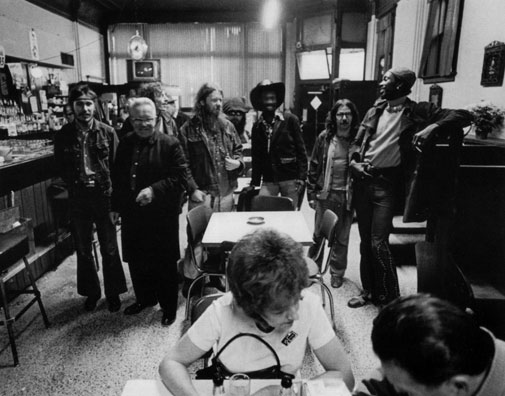
In 1977, two of the three owners of the bar were Brad Jacobsen and William Kulcsar. That January Alderman Zollie Green was on trial for accepting a bribe for voting to approve the transfer of the bar’s liquor license from John Paulson to the new partners in 1975.
In May 1977 the paper began referring to it as the Five Corners Saloon again.
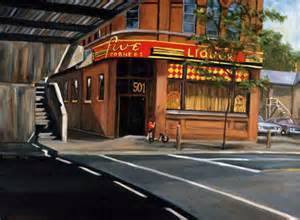
NOMAD PUB
Todd Smith took over the Five Corners Saloon space, opening the Nomad Pub on March 15, 2005. It was modeled after the Nomad on Brady Street in Milwaukee, run by his friend Mike Eitel.
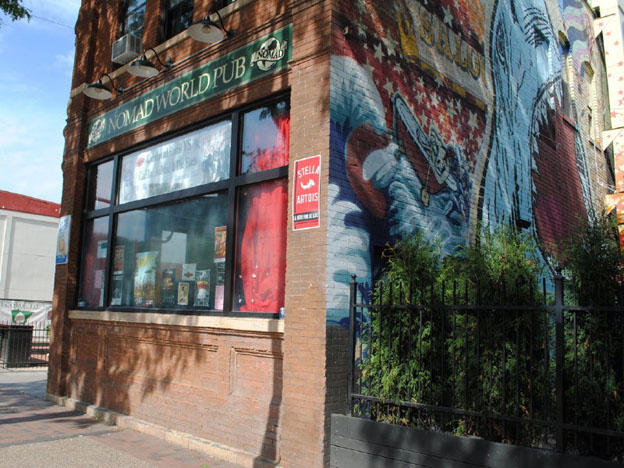
Nomad 2010
Smith put the Nomad up for sale in May 2016. It is now known as the Nomad World Pub.

Please See Foshay Tower.
Flaherty’s Arden Hills Bowl is located at 1273 W. County Road E at North Snelling Ave.
It held its Grand Opening on Friday and Saturday, January 17 and 18, 1964. In addition to bowling, it had a cocktail lounge. The opening featured the Harmonica Hi Hats to entertain the folks.

Minneapolis Star, Tuesday, January 14, 1964
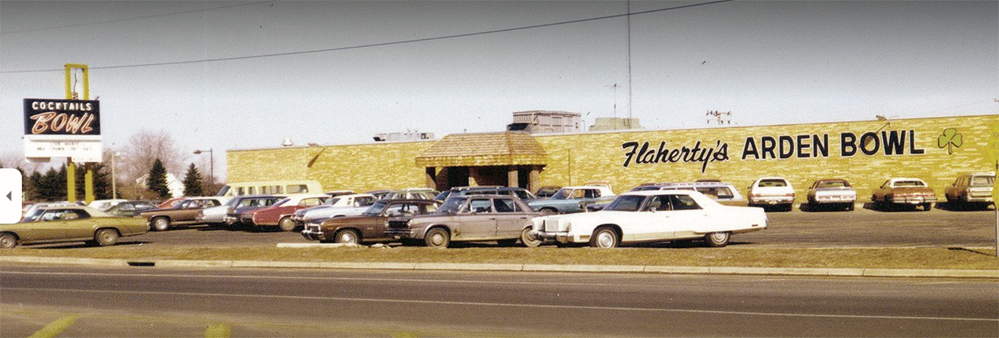
Music listings begin to appear in the Minneapolis papers in 1978. Twist and Shout and Cheeks seem to have been popular bands.
This page covers three different music venues located at 1523 Nicollet Ave. in Minneapolis.
- The Happy Hour Cafe
- Club Carnival
- The Flame Cafe
Please be sure not to confuse this venue with the other three Flames in town:
- The Flame Theater Lounge, 1605-07 Nicollet Ave.
- The Flame Room at the Radisson Hotel
- The Flame Jazz Club in St. Paul
There may be more! As with all my pages, I invite additions and corrections. Most of the information presented has come from old newspapers, which aren’t exactly known for their accuracy. Please Contact Me, preferably by email, if you have better information to share. I would also love to have photos taken inside the Flame, but not those publicity stills of the performers.
THE PERCANSKY BROTHERS
The three venues in this spot were owned and run by brothers Abe Percansky and Raye D. Perkins, two of 11 children of Morris and Edna Percansky. The Percanskys came to America from Jassy, Roumania (now Iasi, Romania) in 1913 and 1914 with eight of their children – the last three were born in America. Raye and Abe were the third and fourth oldest, respectively.
RAYE
Raye David Perkins, born October 9, 1901, was listed as Raphael Percansky in the 1920 Census, and apparently legally changed his name before 1930. Raye took time off from his duties at the club for some very interesting side projects.
Roller Skates: In 1943 he became the publicity director (and possibly co-owner) of “Skating Vanities,” a traveling roller skating show starring Gloria Nord. In 1944 he was quoted as saying, “When you see Gloria Nord on roller skates you will throw bricks at Sonja Henie.” (Des Moines Tribune, January 25, 1944)
Ice Skates: In 1952 Will Jones referred to Raye as the manager of the Flame, but by September 1953, he was somehow Sonja Henie’s manager, and working to get her permission to perform in Moscow, which, according to Wikipedia, she never did. (New York Daily News, September 2, 1953)
A Dead Whale: After some preliminary showings around New York, on May 1, 1954, Raye took a 75-ton embalmed dead whale named Mrs. Haroy to Coney Island as an attraction. Despite daily injections of formaldehyde, the whale’s smell was overwhelming, and on July 1, 1954, he received a summons from the NY Department of Health. This news went out on the wire service and appeared in papers all over the country.
At a hearing on July 20, 1954, the court ordered that the whale had to be chopped up, and the Department of Sanitation would take it to a dump on Staten Island where it would be buried under three feet of dirt. A bench warrant was issued for Raye, who didn’t show up for the hearing. (New York Daily News, July 21, 1954). By August 10, 1954, Will Jones reported that Raye had returned to Minneapolis to manage the Flame.
Raye died on June 13, 1982, and was interred at Lakewood Cemetery in Minneapolis.
ABE
Abraham Percansky was born on April 18, 1903. He often went by Perkins, but he didn’t legally change his name.
From 1921 to 1924 he was a taxicab driver. On April 19, 1924, he drove for the Tip Top Cab Co. and was involved with a murder in front of Vienna Café at 322 Nicollet. Abe and Kid Cann (identified as Harry Bloom, poolroom proprietor) got in a fight over a girl and Abe drew a gun. Kid/Harry took it away from him. Kid/Harry gave the gun back to Abe and the fight resumed. Charles Goldberg stepped in to stop it, and he got shot and killed. Abe was arrested along with Kid/Harry, but eventually Harry Bloom confessed to murder on May 2, 1924. This is confusing because Harry Bloom was Kid Cann’s brother, so who was it?
Abe was arrested in Illinois on July 26, 1924, with 119 gallons of alcohol in his car, along with Patience Barnes, the woman in question in the April shooting. He was not convicted. Note that in the 1980s when Abe’s license was not renewed for the Flame he repeated over and over that he had never been arrested. He had, just never convicted.
Abe was apparently involved with the Ramona Cafe, at 1102 Hennepin Ave. N., as early as 1926 when he received a license for a pool table. He married the former Mildred A. (Mollie) Traub on December 24, 1931, and they ran the Ramona until 1938, when the Ramona’s liquor license was transferred to the new site.
THE BUILDING
The lot was originally numbered 1521 Nicollet, and a two-story wooden dwelling was built on the property in September 1885, according to the City’s building permit card. The demolition permit was taken out on August 1, 1938.
The new building was built in 1938 by Abe Percansky and Raye D. Perkins. The first page of the permit card seems to be missing, so it is unclear when the initial building permit was taken out.
Financing of the building may have been provided by Kid Cann, the head of the Minneapolis liquor syndicate, who then spent many a happy hour at the Happy Hour. There was a great deal of newsprint spent speculating as to whether Cann somehow had an ownership of the club, which would have been illegal for a felon, or secretly ran the place. It was no secret that Cann and Abe were friends. Abe owned it continuously until it closed.
CONFIGURATION
The footprint of the building was long and thin: 50′ by 140′. The space was divided into two rooms. An article from the July 22, 1967, issue of Billboard magazine written by Bill Williams describes the infrastructure. (Some of this may only apply to the Flame era.)
The Front Room was also known as the Lounge or the bar. An elevated stage hung over a circular bar.
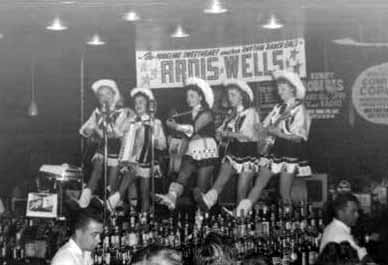
Photo courtesy Brett Williams
A hallway ran between the two rooms.
The Main Room, also known as the Back Room, (the Happy Hour called it the Cabaret and the Club Carnival called it the Fiesta Room) featured the headlining acts. This was a restaurant that seated 282 patrons, a bar, and a square stage.
HAPPY HOUR CAFE
1938
On December 17, 1938, the Minneapolis Star reported that the Happy Hour was built and furnished at a cost of $125,000. Abe Perkins said,
Because we have confidence in Minneapolis and its people, we have erected the finest building of its kind in the country here. Minneapolis is on the upgrade in business and industry, and we want to do our share to help make our native city grow.
The Happy Hour opened on December 21, 1938. Its owner was Ramona Bar & Cafe, Inc. It had the liquor license of the old Ramona Bar & Cafe. Mildred (Mollie) Percansky, Abe’s wife, was Secretary-Treasurer of the Corporation.
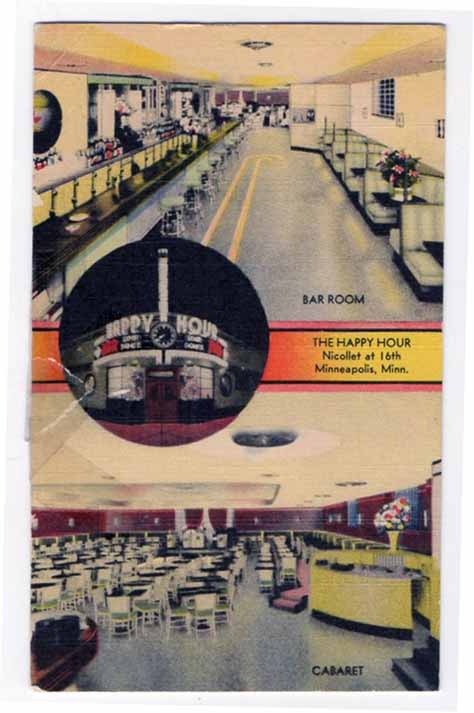
Image courtesy Mary Ann Steinberg Kolb
1940
In 1940 a “skylight” bandit waylaid an employee at 2 am and made off with about $3,000.
In May 1940, a charge of gambling aimed at Mildred (Mollie) Percansky, Abe’s wife, was dismissed when she testified that she didn’t know that the “14” game or “California Dice” were going on. Besides, said her lawyer, Archie Cary (Gangland’s go-to Attorney), the police should have charged the corporation, not her, as she was only the Secretary-Treasurer.
In October 1940, the popular Freddy Fisher’s Schnickelfritz cornball orchestra was in session at the Happy Hour.
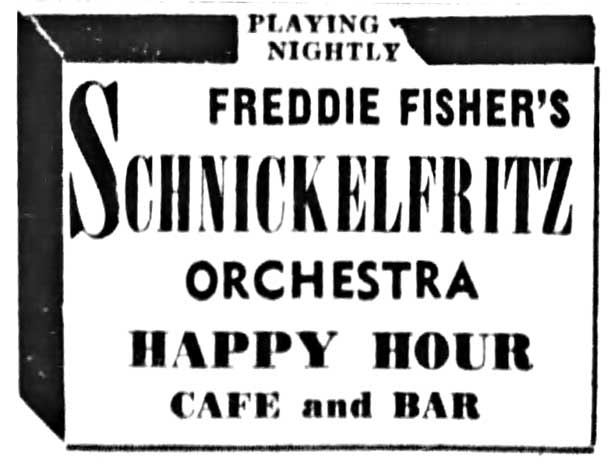
Minneapolis Tribune, October 17, 1940
1941
Abe Perkins remembered that in 1941,
each table had a clock on it – and every hour on the hour we gave away a bottle of champagne, imported champagne. That’s why we called it the Happy Hour. We used to have four cooks in the kitchen and it was open until midnight. (Minneapolis Star, May 12, 1977)
Starting on December 21, 1941, and continuing through January 1942, Walter Fuller, the “King of Jive,” performed with an a “Giant All-Star Colored Review” that included:
- Nelda Du Pree, “Sensational Creo Vocalist”
- The Three Businessmen of Rhythm
- Lon Chaney, “The Wizard Contortionist
- George Gould, “Dynamic Master of Ceremonies and Tarza???”
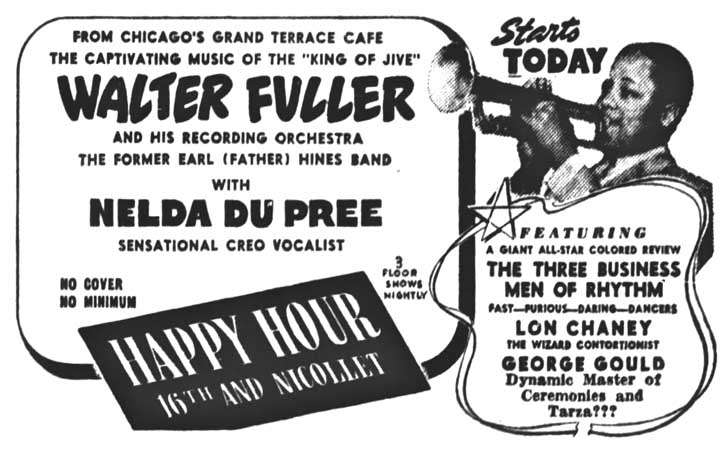
Minneapolis Star, December 21, 1941
1942
The club scored a coup by booking Fletcher Henderson for at least a week in June – July 1942.
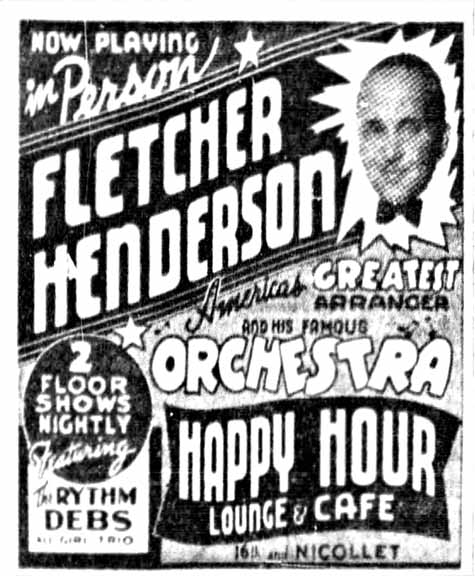
Minneapolis Tribune, June-July, 1942
A VERY STRANGE STORY
On November 23, 1942, Pvt. Harold Bartholomew went to the men’s room at the Happy Hour and encountered one Larry Dugan, alias Harry Bever, civilian. Bever’s gun fell out of his pocket, and Bever was somehow compelled to say, “I’m tough.” Pvt. Bartholomew, perhaps unwisely, responded, “If you’re so damn tough, why don’t you join the Army and do some fighting?” So Bever shot him in the jaw. (Minneapolis Star Journal, November 24, 1942)
Bever and his two fellow thugs were captured and sent to prison in Cincinnati for trial for a bank robbery there. They escaped with two kidnappers on February 12, 1943, and Bever was picked up in Amarillo, Texas, on July 24, 1943, in a roundup of suspects in the murder of an Amarillo cafe man. It turned out that he was a deserter from the Army, and he was also convicted of the murder by a general court martial, although he denied the murder. He was hanged at Fort Sill, Oklahoma, in October 1944. (Minneapolis Tribune, October 9, 1944)
Bartholomew then sued the club for serving drinks to Bever, until he became “highly intoxicated, vicious, reckless, ugly and abusive,” seeking $50,000 in damages from the owners of the bar. Witnesses who were employees of the bar were discredited by giving conflicting testimony as to who was drunk, if anyone. The jury awarded Bartholomew the full $50,000, “one of the largest verdicts ever returned in a Hennepin county district court civil action,” reported the Minneapolis Tribune on December 8, 1944, but the amount was reduced by the court to $40,000. This was further reduced to between $15,000 and $20,000. (Minneapolis Tribune, July 17, 1945 and February 28, 1950)
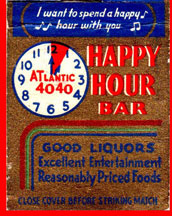
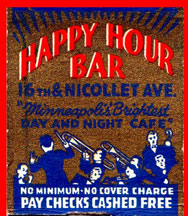
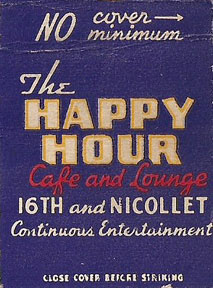
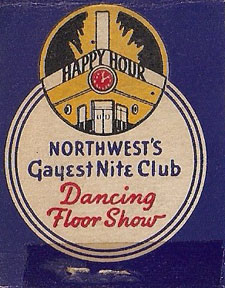
The musicians below may be the Jay McShann band.

Musicians at the Happy Hour, July 18, 1942. Image courtesy Minnesota Historical Society
1943
Tiny Hill weighed in at 365 pounds and was known for a 1925 song called “Angry,” which doesn’t sound a bit angry…
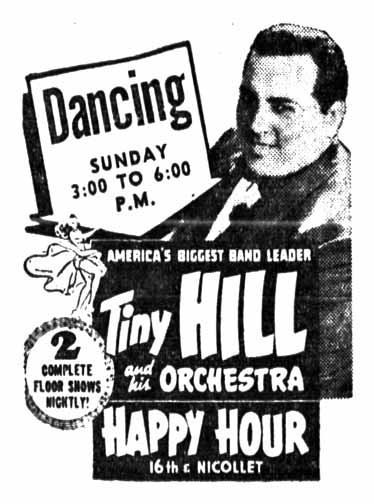
Minneapolis Star, March 19, 1943
1944
In 1944 the acts appear to have devolved to vaudeville and showgirls.
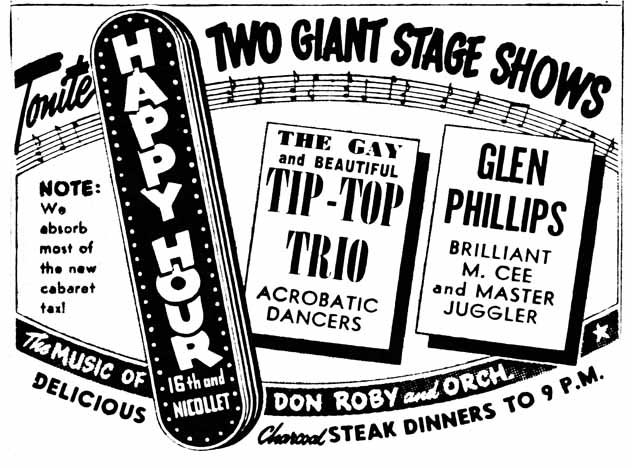
Minneapolis Tribune, July 2, 1944
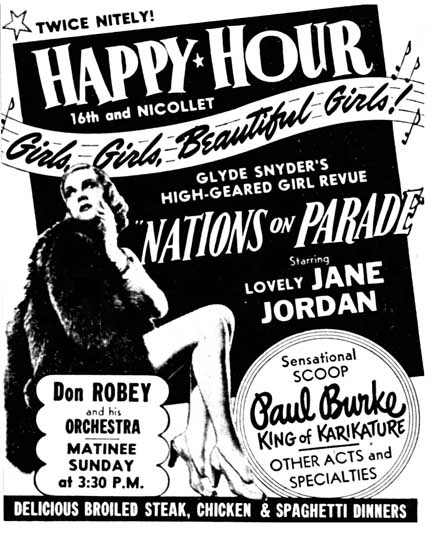
Minneapolis Tribune, October 4, 1944
1946
By the end of the War, the women bandleaders were probably very accomplished.
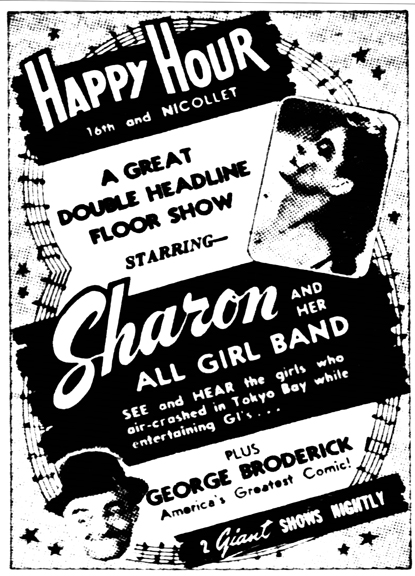
Minneapolis Star, June 21, 1946
Here’s another big orchestra leader.
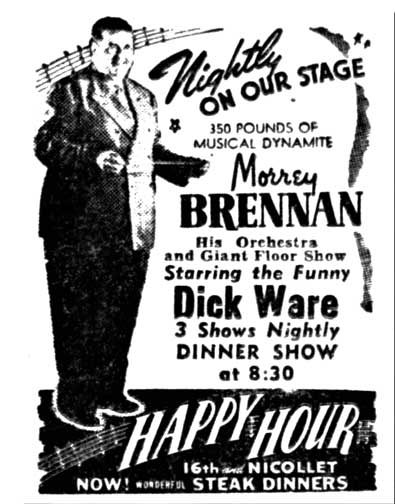
Minneapolis Star, October 11, 1946
1947
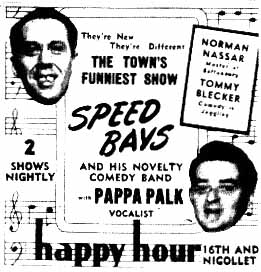
January 21, 1947
The photo below is way too dark, but Pappy Trester and his Famous Screwballs were on par with Freddie Fisher’s Schnickelfritz Orchestra – more Cornball music that was all the rage in the 1940s.
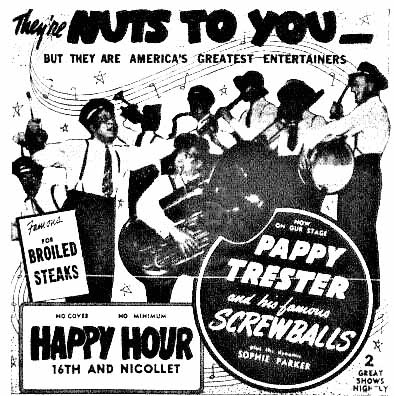
Minneapolis Star, February 13, 1947
The Screwballs were either back or still there in September 1947.
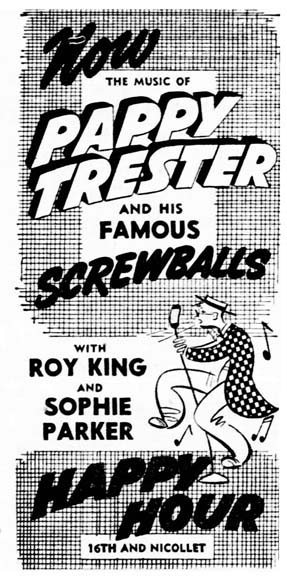
Minneapolis Tribune, September 1947
FIRE AT THE HAPPY HOUR
On November 5, 1947, at about 7 pm, fire broke out at the club, killing one fireman. Henry A. Obinger was one of nine firemen inside the building when the ceiling collapsed. The fire started in a glass-enclosed kitchen where a cook had just lighted a gas broiler. Flames flared up and ignited the grease chute over the broiler, into a small attic over the bar. Smoke drove about 50 patrons into the street. The ceiling collapsed after about 20 minutes, showering plaster and laths on the firemen. Three alarms were called to fight the fire, and spectators had to be roped off. (Minneapolis Tribune, November 6, 1947)
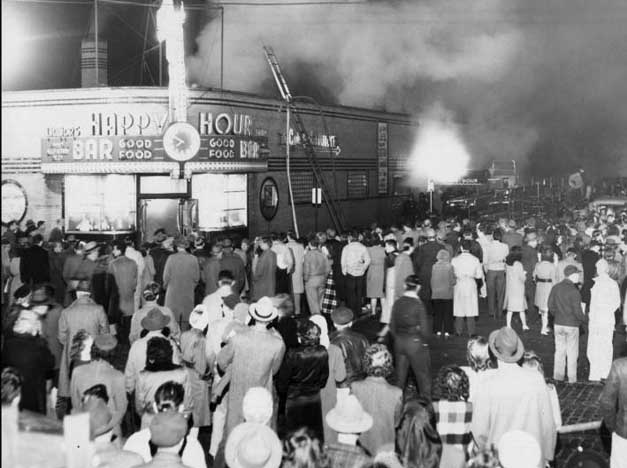
Photo courtesy Hennepin County Library
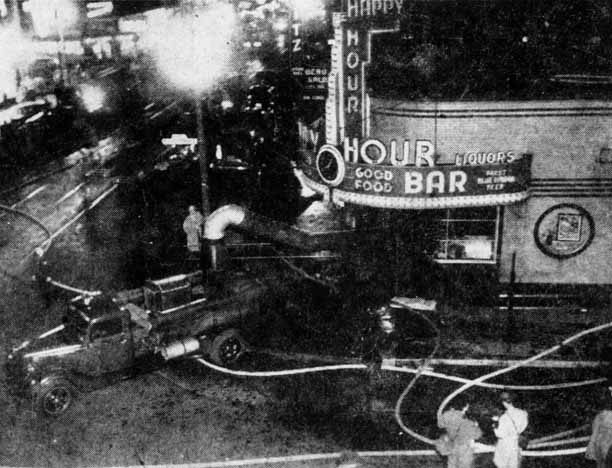
Minneapolis Star, November 7, 1947
And that was the end of the Happy Hour Cafe.
RECONSTRUCTION
When it came time to rebuild, the first order of business was to make the ceiling stronger. A catastrophic fire at the Cocoanut Grove nightclub in Boston on November 28, 1942, was the deadliest nightclub fire in history, and second-deadliest single-building fire in American history, claiming 492 lives. After that fire, construction laws were changed, and the Happy Hour’s ceiling could not have been built the way it was after 1942. All agreed that the reconstructed building must have higher construction standards.
During reconstruction, in December 1947, a 34′ by 50′ concrete and steel addition was built at an approximate cost of $15,000, according to the building permit.
Air conditioning was added in January 1948 at a cost of $10,000.
CLUB CARNIVAL
1948
BALLYHOO FROM CEDRIC
Cedric Adams was the first to announce that the club would have a new name – “The Carnival” – and a new policy of name bands with big price tags,
which show you that the refurbished Sixteenth street place is out after the carriage trade. The new interior will amaze you. The decorations will be elegant but subdued. The seating capacity will be shoved up to over 1,000. Tentative date for opening is April 1. The management says it will be one stab to see whether Minneapolis and the Upper Midwest will be willing to support the top bracket of entertainment offerings. We’ll all be interested in the outcome. (Minneapolis Star, January 29, 1948)
On March 29, 1948, Cedric gushed over the place again:
If ever a spot has been “done over” it’s the Club Carnival. Only residual trace of the Happy Hour is the location and the outside walls. The Seben people, designers and architects, began immediately following the fire and ripped the old place apart. Awaiting the grand opening will be really quite an elegant little supper club. Maybe “little” isn’t the word. It’ll seat 450 people.
He describes the Front Bar:
From the entrance on Nicollet you go into a cloverleaf stage bar done in walnut paneling. Carnival characters are in relief against a canvas background on the walls. A three-piece stage unit will entertain from 5 pm on here …
THE HYDRAULIC STAGE
Then he describes the Main Room, which he calls the Fiesta Room. It was at this point in the club’s history that the hydraulic stage was installed.
The Fiesta room (in the rear) will feature a hydraulic stage that rises [four feet to be] even with the bandstand. The stage is a section of the dance floor. The rise gives everyone of the 450 guests perfect vision of the entertainment. Indirect lighting, rheostat-controlled, will give off almost every color of the rainbow for effects. Innovations include a waitress signaling system, backs of booths that rise to the ceiling, a glass wall done in tubular mirrors, a backstage decorative effect that has 2,000 individual lights.
Top budget for entertainment is $7,500 a week which means there’ll be quite a nut to crack. Very few bookings in the first 13 weeks of the present schedule run lower than $6,500. It’ll be interesting to see how Minneapolis reacts and whether the community will support offerings in this bracket. With rooms and clubs closing all over the country under economic pressure, this type of expansion is indeed unusual. April should tell the story.
Mildred Percansky was no longer an officer on the board of Ramona Cafe, Inc., which held the liquor license. The new officers were Ted Cook, manager and president; Ruth Cook, secretary and treasurer; and Gordon F. Gertz, Vice President.
(Interestingly, Yiddy Bloom’s probation officer said that Yiddy (Kid Cann’s brother) was the manager of the club!)
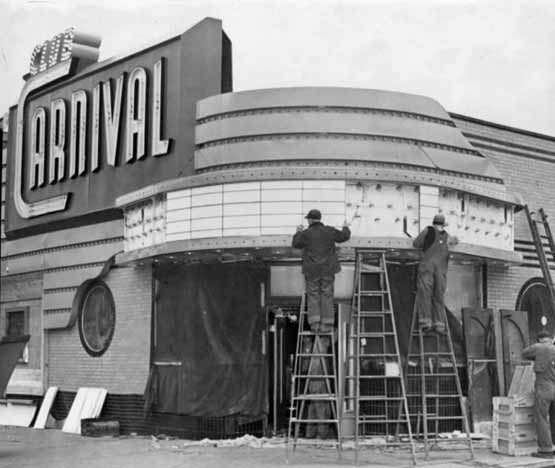
Putting up the sign at the last minute, April 8, 1948. Photo courtesy Hennepin County Library
OPENING NIGHT
The Club Carnival Night Club opened on April 8, 1948. Frankie Carle and his band were the first to entertain.
Cedric’s report was glowing:
Last vestiges of the old Happy Hour vanished last night with a grand opening of the new Club Carnival in the spot on Sixteenth and Nicollet. Some 700 guests thronged into the two new rooms that make up the Club Carnival and opinion seemed to be unanimous that the layout is fully as elegant and glamorous as anything between our two coasts. Outside of a few opening night bugs, little things that are expected to go haywire, nothing but complimentary remarks could be heard for the new surroundings, the new policy, the latest addition to the city’s night life.
Seating arrangements are perfect, the stage that rises gives excellent vision, the dance floor seems amble and the entire surroundings reflect taste – good taste. The management couldn’t have selected a better band than Francie Carle’s for the opening. The maestro was exceedingly generous with his Carle classics. His little rhythm section brought howls of approval from the packed house. It’s a joy to listen to the Carle outfit with an intimacy you don’t get in a theater. If the success of an opening night is at all indicative of the future, Club Carnival is very apt to slide into the No. 1 spot locally. (Minneapolis Star, April 9, 1948)
Adams continued to report on the success of the club, saying that Frankie Carle played to capacity houses for his entire week’s run, which added up to 400 people per night in the Fiesta (Main) Room and 600 packed into the Front Lounge. The next act was Hal McIntyre, which was odd, because there was a “national” Hal McIntyre and a “local” Hal McIntyre. While “national” was here, the two Hals got together for a nice chat. (Record fans knew the difference.) Reservations for the club were coming from as far west as Idaho and as far east as Ohio! (Minneapolis Star, April 20, 1948)
ACTS AT CLUB CARNIVAL
The following are the acts, as best I could find, that appeared during the short tenure of the Club Carnival. I will post ads of the bigger names, and merely list some of the smaller, or at least the more common bands that have appeared at other venues around town, such as the Prom and Marigold Ballrooms. Dates are not all inclusive – I’ve tried to capture opening nights, but I can’t guarantee that I have. Some ads, though fabulous, were just too dark to translate to the screen. Those lucky enough to have caught these name acts at the Club Carnival before it went broke must have remembered those nights forever!
The Blue Barron Orchestra followed Frankie Carle with a two-week engagement – piano star Jan August was featured. The sports page reported that on May 6, 1948, Mr. Barron and his 14-man band will take over the St. Louis Park driving range in a “mass attack exhibition” at 3 pm.
Clyde McCoy and His Orchestra; Jimmy Ray, America’s Most Unusual Dance Act; and The Madcaps, Musical Comedy Twins: May 1948. Oh, perhaps in appreciation for his kind remarks about the club, in the early days, shows featured the winners of Cedric Adams’ “Stairway to Stardom” show. Such were the Madcaps.
The Charlie Spivak Orchestra with the captivating Irene Daye; Gorgeous Dance Sensation Nancy Bell; and Star Impersonator Frank Payne, winner of, well… : June 1948.
Nick Stuart and His Orchestra, featuring Jeff Swift; The 3 Lind Brothers; the Gorgeous Dolly Barr, Loveliness in Syncopation; and the unnamed winner of Cedric’s: July 1948.
Professor Backwards, Dean of Laughology; Sonny Howard, Arthur Godfrey’s Singing Discovery; and on Monday nights, dance teacher David LaVay gave Rhumba lessons. And Cedric. December 1948.
Matchbook below from the Collection of Mark Youngblood
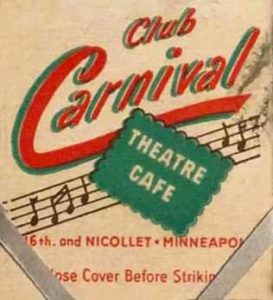
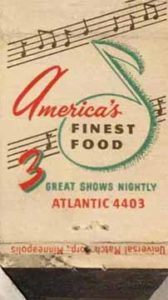
1949
Harry Cool and His Orchestra; The Charioteers, from the show “Hellzapoppin;'” and Janet Lynn, Dancing Unique. No Cedric. January 1949.
Gil Lamb, Minneapolis’s own Rollicking Star of Motion Pictures; Perry Martin and His Orchestra; and Helen Forrest, voice of 10 million records: February 1949.
Nellie Lutcher, the “Real Gone Gal:” opening March 3, 1949. Now I would definitely go see Nellie!
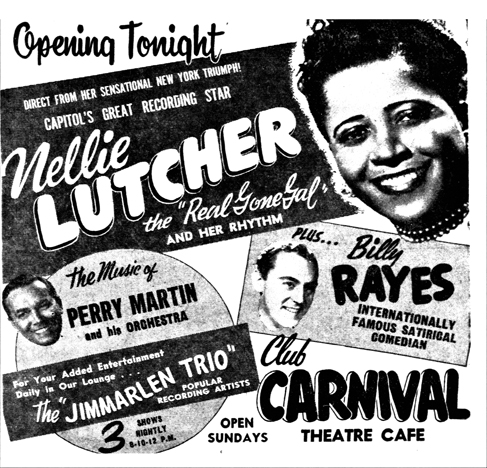
Minneapolis Star, March 3, 1949
Vivian Blaine (remember her from “Guys and Dolls,” which hadn’t been made yet); Hal Fisher, Your Laff Salesman: March 20, 1949
Perhaps the first really big star was Martha Raye, with the Ben Yost Singers: March 31, 1949
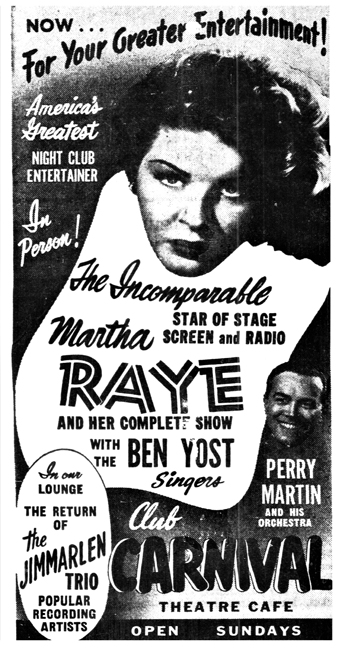
Minneapolis Star, March 31, 1949
Cedric Adams reiterates the Club Carnival’s big name policy and success in his column in the Minneapolis Star of April 28, 1949:
Name acts only is the new policy at Club Carnival in Minneapolis. After the management finished paying Martha Raye her $6,000 per week, it found the bistro operating in the black so then and there decided on nothing but stars and big stars. Apparently it has been discovered that Minneapolis patrons will flock to good entertainment but stay away in droves from the mediocre.
Mel Torme and Comedienne Jean Carroll, April 28, 1949
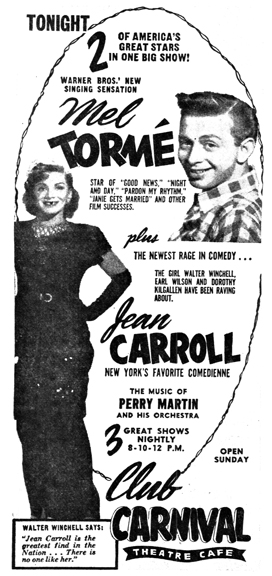
Minneapolis Star, April 28, 1949
Romo Vincent, America’s Singing Comedian; and Borrah Minevich’s Harmonica Rascals: May 19, 1949.
Sophie Tucker, the Queen of Entertainment, with Ted Shapiro at the piano. Exclusive songs by Jack Yellen. Also Folie Miller, Dance Stylist and Martin Barnett, Comedy Magic: June 5, 1949.
The Ink Spots, with Dance Stylists Son and Sonny: June 9, 1949
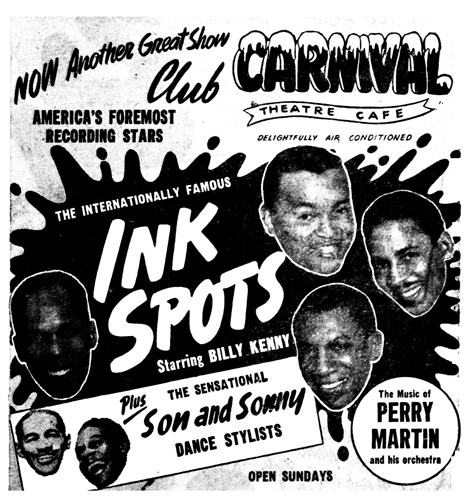
Minneapolis Star, June 9, 1949
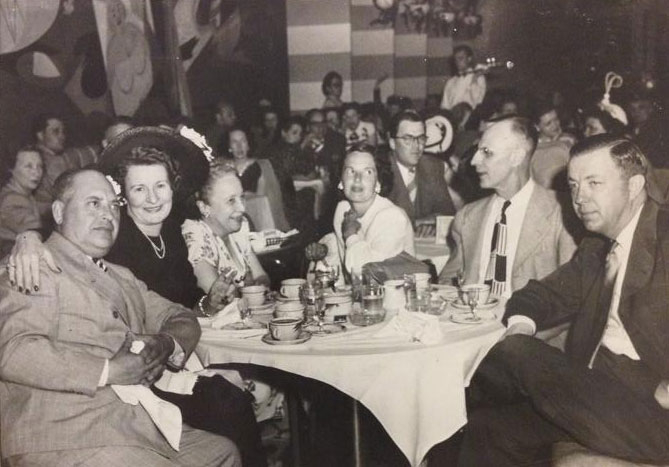
Revelers at the Club Carnival enjoying the Ink Spots, 1949 – posted by Tracy Wych
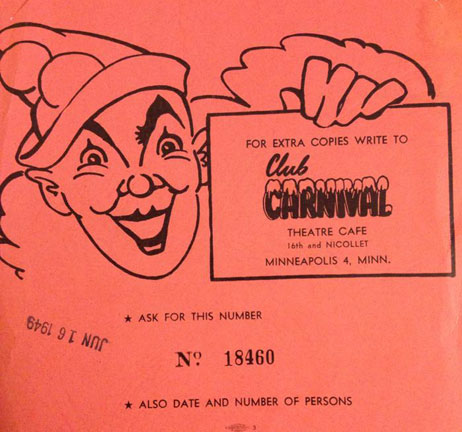
This folder with evil clown on the back courtesy Tracy Wych
Harry Richman, America’s Greatest Entertainer, with Joe Harnell at the Piano. Also the riotous Laurette and Clymas, Scintillating Comedy Stars : June 23, 1949
Joan Edwards from “Your Hit Parade,” playing her songs from the piano. Also Buddy Lester, Television’s Gift to Great Comedy and Funny Man of the Year. Plus Betty Hill in Modern Dance: July 24, 1949.
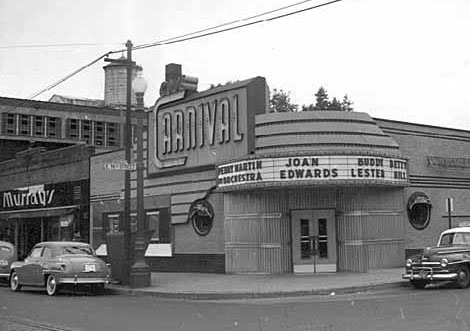
1949 photo from Minnesota Historical Society
Cab Calloway: August 4, 1949
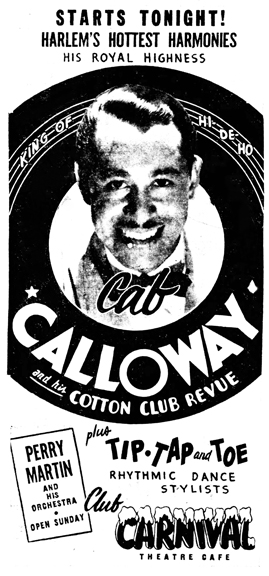
Minneapolis Tribune, August 4, 1949
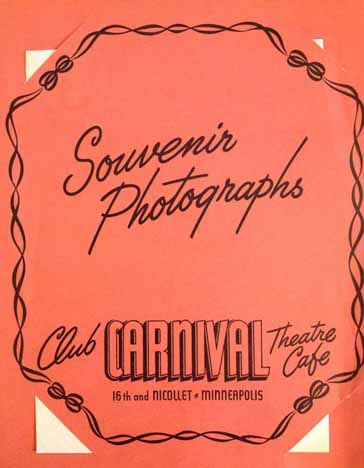
This folder came with a picture of Cab Calloway. Courtesy Tracy Wych
Harvey Stone, Star of Stage, Scream, and Raveyo; and Frances Faye, “Queen of Clubs,” New York’s Newest Comedienne: August 21, 1949.
Lena Horne, with Comedian Sonny Mars: September 1, 1949
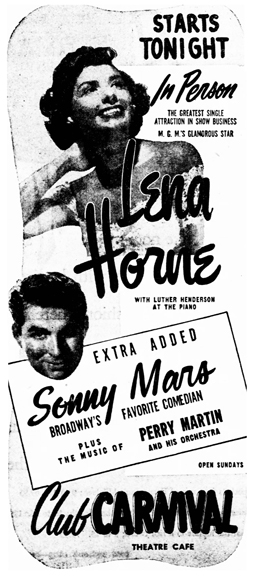
Minneapolis Tribune, September 1, 1949
King Cole Trio with Comedian Willie Shore: September 20, 1949

Minneapolis Star, September 22, 1949
The King Cole Trio got a rousing review from John K. Sherman, who revealed that the Trio was really a foursome with the addition of Jack Constanza on Cuban drums. (Minneapolis Star, September 22, 1949)
Ted Lewis; September 27 into November, 1949. His world-famous orchestra and giant revue, featuring:
- Geraldene Du Boise
- The 3 Reed Sisters
- Meribeth Olds
- Paul White & Elroy Peace
Beatrice Kay, Gay Nineties Girl; Jan August and his piano music: November 24, 1949.
1950
Connee Boswell, Impressionist Dean Murphy, and singing Emcee Al Grant: January 8, 1950.
The Ritz Brothers began a 13 day run on January 13, 1950. On the bill were the Sensational Maxellos, the singing Emcee Al Grant, and the Club Carnival Orchestra.
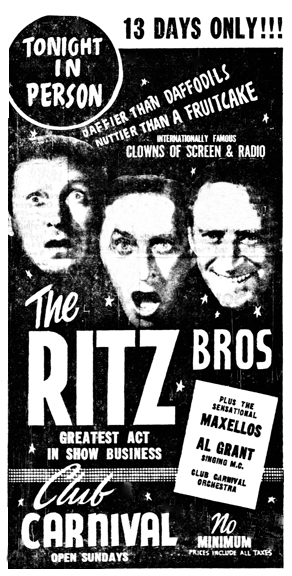
Minneapolis Tribune, January 13, 1950
Sophie Tucker was back on January 26, 1950, with comedian Vic Eyde and the Bob Locken Orchestra.
Carmen Miranda with her Bando Da Lua, Comedian Gary Morton (Lucy’s husband), Emcee Dick Gordon, the Club Carnival Orchestra, and Carmen Garcia and Her Rhumba Band: February 9-22, 1950.
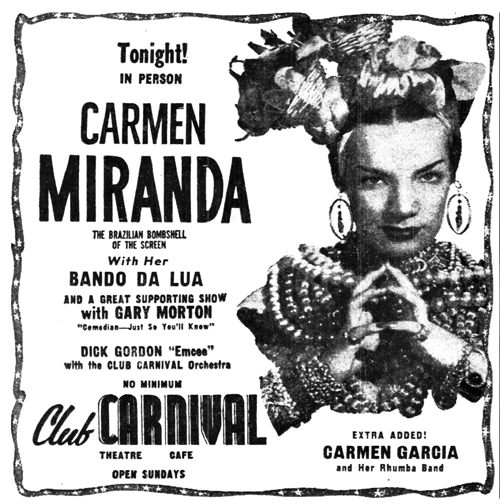
Minneapolis Star, February 9, 1950
Delta Rhythm Boys, Asian movie star Keye Luke, modern tap dancer Vera Love, Carmen Garcia and Her Rhumba Band, with Dick Gordon and the Club Carnival Orchestra: February 24, 1950.
Martha Raye made a repeat appearance with the Ben Yost Singers and the Bob Locken Orchestra on March 9, 1950.
The Mills Brothers, with Comedian Ray English and Bob Locken’s Orchestra: March 23 , 1950.
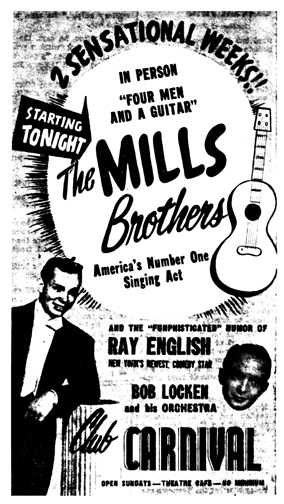
Minneapolis Tribune, March 23, 1950
On April 6, 1950, Peggy Lee came with her own Quartette, and Comedian Billy Rayes. Bob Locken’s was apparently the House Orchestra. Business had been waning, but on April 7, 1950, the Club took off its cover charge and things picked up. (Minneapolis Tribune, April 17, 1950)

Minneapolis Tribune, April 7, 1950
Mel Torme made a repeat performance, again with Jean Carroll, now billed as the “Female Milton Berle.” Bob Locken and His Orchestra: May 7, 1950.
Dorothy Donegan, Broadway’s Newest Sensation, America’s Dynamic Piano Personality. With Charley Chaney, Comedy Star of Radio and TV and the Dorothy Dorben Dancers. Bob Locken’s Orchestra: May 25, 1950.
Sarah Vaughn, with Comedian Paddy Brown: June 11, 1950.
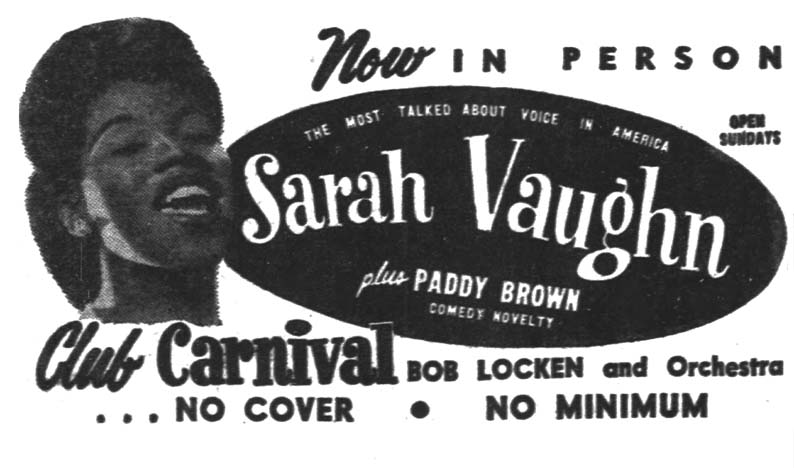
Minneapolis Tribune, June 11, 1950
RUMORS ARE FLYING
Rolf Felstad of the Minneapolis Tribune reported on rumors that the Club Carnival was going to shut down and that its liquor license would be moved to the Flamingo Bar, 1 E. 26th Street, then a 3.2 tavern. This rumor was hotly denied by the Ramona Bar and Cafe, Inc., holder of the license.
Cook said that the Ramona had a lease that had two and a half more years to run. However, they had been discussing modifying their entertainment policy, although they had name acts booked through May. Rumor had it that the club was losing up to $150,000 a year, although it hadn’t even been open for a year. It also reported that in the Happy Hour days,
as now, it was the happy and frequent haunt of Kid Cann, long a leading figure in lower Minneapolis society. (February 18, 1950)
Despite Cook’s insistence that the club wasn’t going to move, a petition with 1,500 names was submitted to the City Clerk opposing the transfer of the Club Carnival’s liquor license to the site of the Flamingo Cafe, signed by members of the Whittier neighborhood. The article implied that there was application had indeed been submitted. (Minneapolis Tribune, April 4, 1950)
THE CARNIVAL’S OVER
As it turned out, the Club Carnival shut down in June 1950. Its attempts to bring national acts to Minneapolis had resulted in high prices and cover charges, which led to its downfall. (Will Jones, Minneapolis Tribune, February 7, 1951) Its liquor license was transferred to 1504 East Franklin Ave. (Addison’s Bar, where the assistant manager was none other than Yiddy Bloom, Kid Cann’s brother!) The plan was for Albert L. Addison to have his beer license transferred to the 16th and Nicollet location, which was approved on June 30, 1950, but Addison never picked up the license.
THE FLAME CAFE
1951
By January 18, 1951, the Club Carnival sign was down and the new Flame sign was up on the building at 1523 Nicollet, although the transfer of the licenses had not been finalized. Samuel Markowitz was identified as the assistant manager of the Flame. Markowitz had applied for the 3.2 beer license held by Albert Addison at the Carnival but not used. (Minneapolis Tribune, January 18, 1951)
In 1951 the license of the original Flame Theatre Lounge, which had been located at 1607 Nicollet across 16th Street on the same side of Nicollet, was transferred here to 1523 Nicollet.
MY OLD FLAME?
Will Jones dedicated most of his February 7, 1951, column in the Minneapolis Tribune to the new Flame Cafe, due to open the following Wednesday. He described it as just a continuation of the original Flame Theater Cafe at 1607 Nicollet, “a night spot featuring dancing girls in scanty costumes and accompanying glitter.”
He also described Ray Percansky as merely the owner of the building, who would “be on hand for a few months to help the new tenants launch the place with an atmosphere to be patterned after such flashy eastern establishments as the Copacabana and the Latin Quarter.”
The new Flame will offer three shows a night. There’ll be a line of six of the above-mentioned dancing girls, assorted vaudeville acts and an orchestra. There’ll be a new show every two weeks. Glyde Snyder will produce. Acts will be brought in from New York and Chicago, but there’ll be no attempt to re-establish the big-name policy which reportedly lost large chunks of money for the Carnival, Perkins said. The Carnival name is being abandoned along with the high prices and cover charges associated with it, he said.
“There hasn’t been a real good hoop-la place in town for a long time,” said Perkins. “I think we need it.”
THE FLAME IS LIT!
The opening show on February 14, 1951, featured:
- Bobby Baxter, “Hilarious Funster and TV Star” (Might be this magician)
- Harriet Blake, singing comedienne
- Kathryn Leigh, “Singing Sweetheart of the Air Waves”
- LeRoy Fisher’s Orchestra
- The Glorianna Dancers
- Johnny Simmons, singer and M.C.
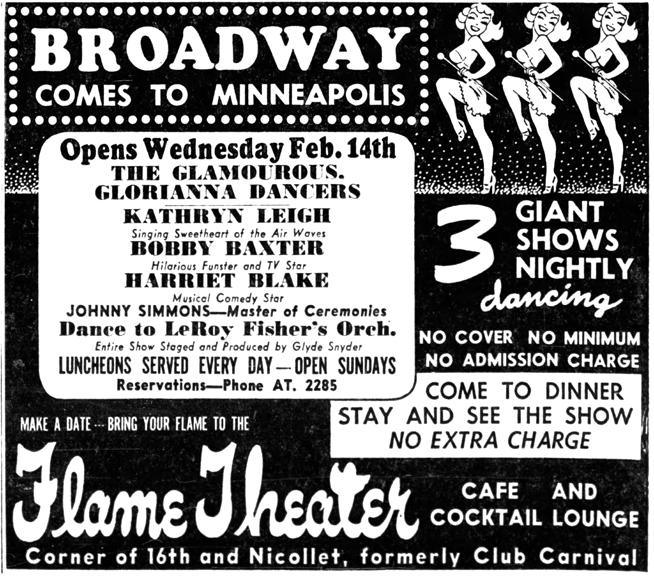
Minneapolis Tribune, February 1951
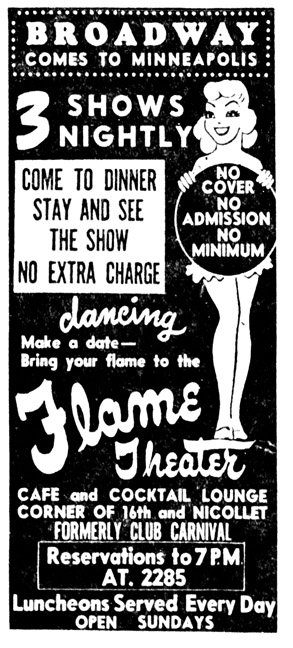
Minneapolis Star, February 22, 1951
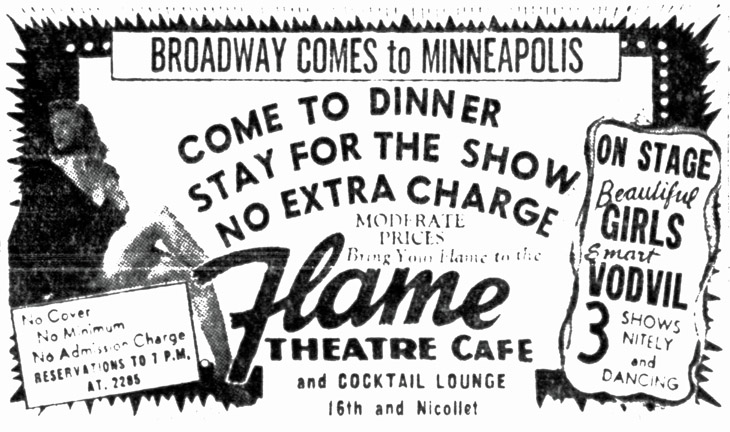
Minneapolis Tribune, April 20, 1951
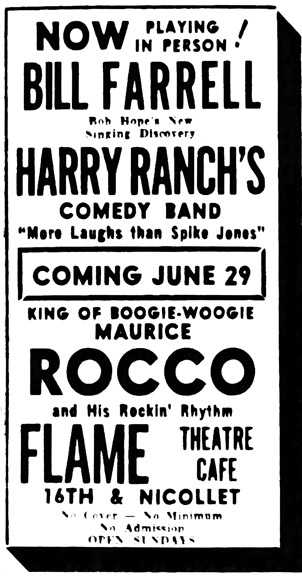
Minneapolis Tribune, June 24, 1951
In December 1951, the Flame inaugurated a new vaudeville policy, and for the occasion recruited a band capable of sweet, Dixieland, or advanced jazz. Personnel included:
- Marvin Dahlgren, drummer and percussionist with the Minneapolis Symphony Orchestra
- Rufus Webster, pianist with a master’s degree in music from the University of Minnesota
- Charles Beasley, sax, graduate of the MacPhail School of Music
- Irv Williams, leader, veteran of the Count Basie and Billy Eckstine Orchestras.
Minneapolis Tribune, December 2, 1951
1952
JAZZ CAROUSEL
In January 1952 the Flame began to program jazz on Sunday nights, a show called “Jazz Carousel,” produced by bandleader Bruce Dybvig. Both Dixieland (Harry Blons) and modern (Percy Hughes) jazz were presented. In October 1952 the Four Notes were ongoing entertainers.
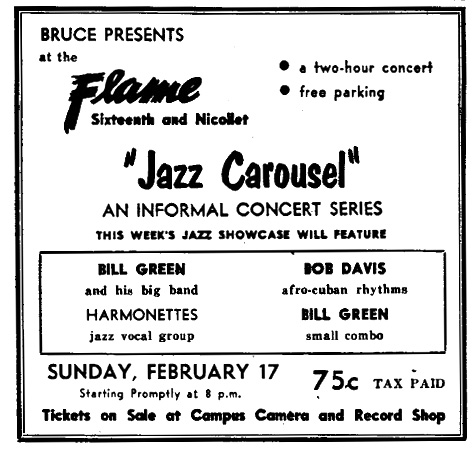
Minnesota Daily, 1952. Courtesy Robb Henry
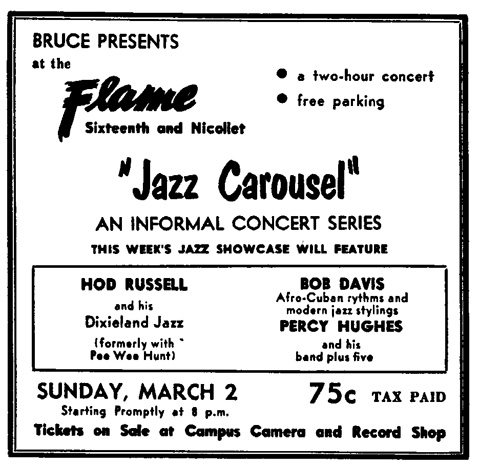
Minnesota Daily, 1952. Ad courtesy Robb Henry
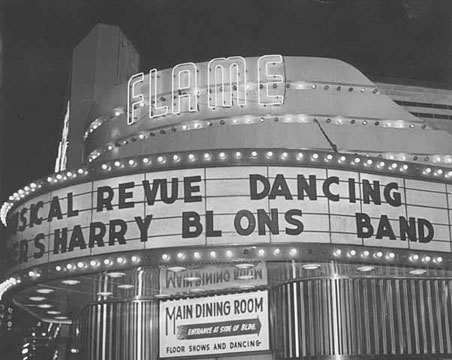
In 1952 the Flame was the “House of Music,” seemingly bringing in a better class of music to the stage.
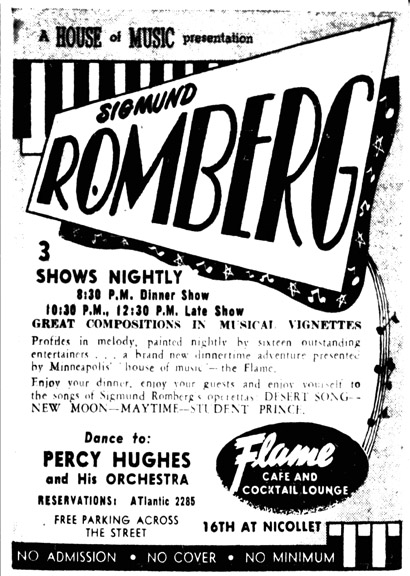
Minneapolis Star, May 2, 1952
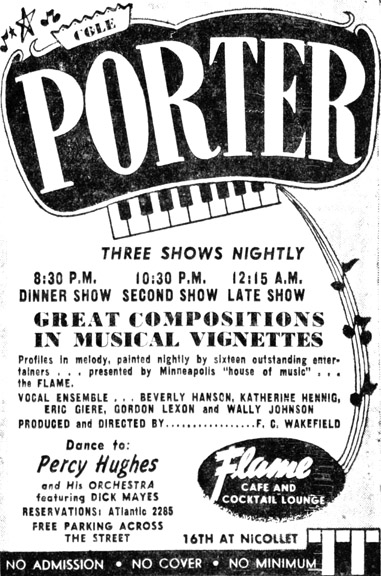
May 30, 1952
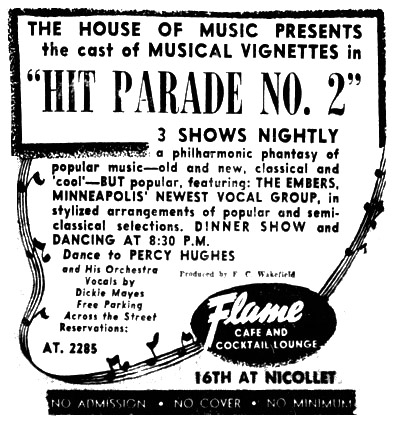
July 18, 1952
This show in September 1952 indicates that the floor show was back.
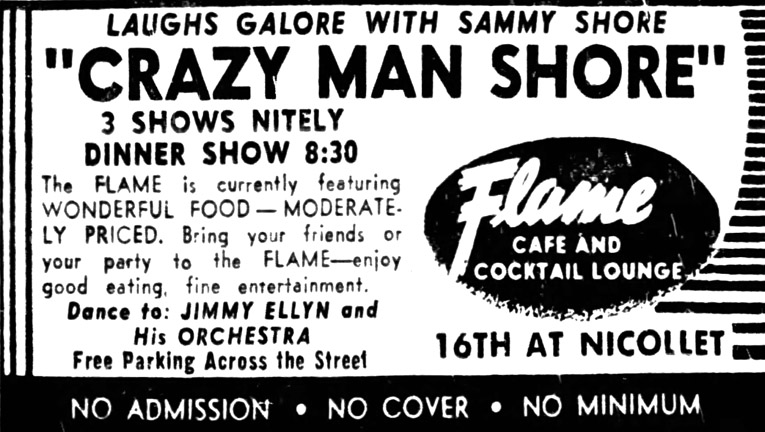
Minneapolis Star, September 12, 1952
In October 1952 an article on liquor licenses indicates that Mrs. Freda Swartz, 2716 Drew Ave., was the former operator of the Flame at 1523 Nicollet. Freda was the sister of Kid Cann’s wife.
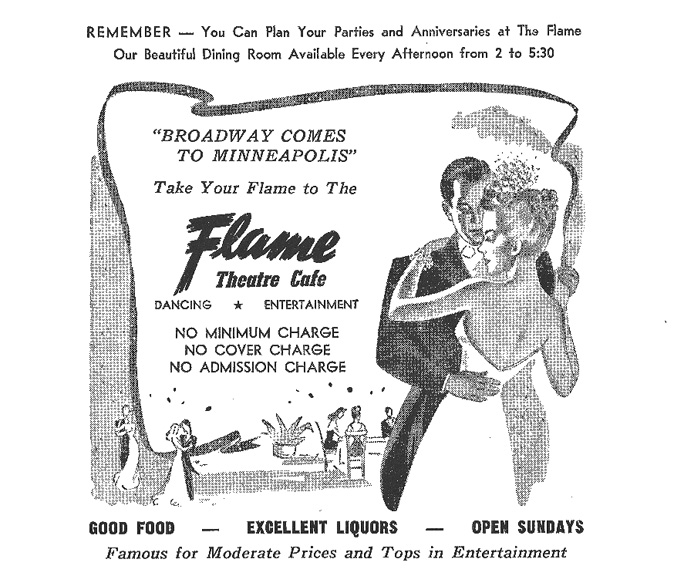
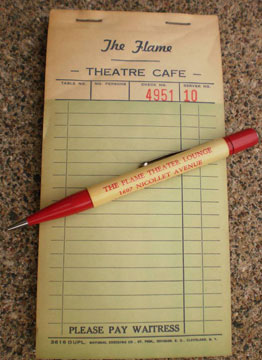
WHERE’S MY HUSBAND?
In October 1952, you could register for $2,000 in Wonderful Prizes by naming the Flame’s “Mystery Husband!” 12 clues were given out over WTCN radio. To register, you had to go to the Flame on Monday, Wednesday, or Friday between 2 and 5 pm, where you were urged to stay for a Cocktail Lunch. “Where’s Your Husband?” was a new radio show broadcast over WTCN radio from the Flame, featuring DJ Sev Widman.
1954
Confusion reigned over the Flame’s application to renew its liquor license. The names on the original license were:
- Frank M. Connor
- Mabel Rails
- Ida Beell
- Joseph E. Connor
- Vienna Niemi
- Irene Bodine
The 1954 application came in without the first two names, making the license committee wonder if this was a renewal or a new application. It mattered, because new applications had been frozen.
Here in mid-1954 there are no T-Bone steaks as yet, but dinner is still cheap!
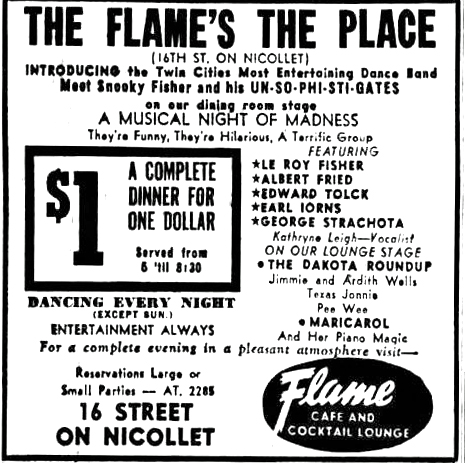
June 11, 1954
The ad below indicates that in August 1954 the Flame was still trying to find its identity. It may also be the start of the Flame’s famous T-Bone Steak Dinner.
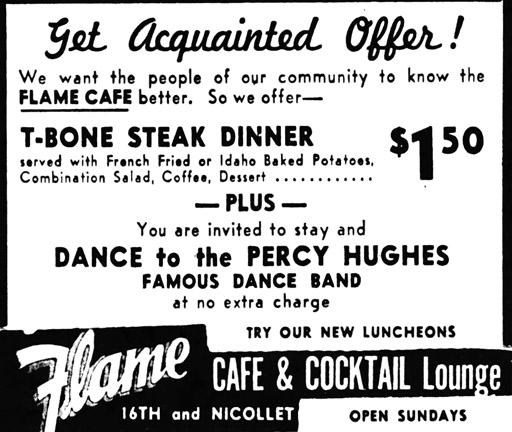
August 24, 1954
The Flame was not yet the Flame. Will Jones writes of strippers in his September 23, 1954, column – specifically “Taika” at the Flame, who walks out into the audience on a runway. “We’re giving ’em 3-D,” said Raye.
Taika dances barefooted. She has been in the habit of sneaking throught the audience in the darkened club, slipping off her shoes at the audience end of the runway and suddenly making her appearance in the midst of the people as the lights flash on. Twice somebody stole her shoes from the end of the runway. Now she leaves her shoes in her dressing froom and gropes among the tables bare-footed to make her trick entrance.
Will Jones item in the Tribune, December 17, 1954:
Percy Hughes is going in for semi-classical dinner music during the early hours at the Flame. “Call me Percy FAITH Hughes,” he requested. Rufus Webster’s piano has been wired so it sparkles all the way to the back of the big room along with the full band, and the sound is good. Sophie Parker also has moved her bulk into the Flame.
Below is an image of a Sophie Parker record provided by record collector Rod Wideman. Did it belong to Sophie, or someone named Sophie Parker who lived in Minneapolis? The singer Sophie Parker was from Texas and was known as the “Kate Smith of the South,” says Minnesota record expert Derik Olson. Also see Derik’s blog.
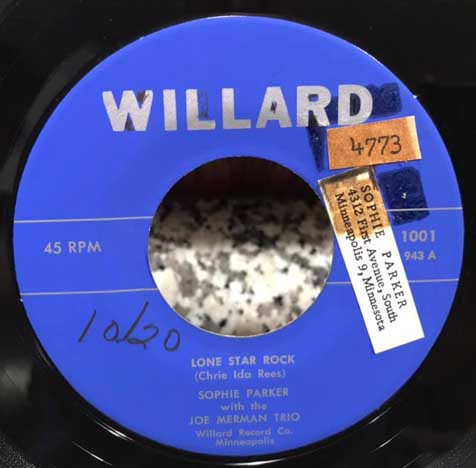
Image courtesy Rod Wideman
1955
THE JAZZ AGE
Another format shift came in 1955 when national jazz acts were booked. Each act was hired for as long as they were available, so some were at the Flame for weeks, while others just for days.
The first of these big acts was saxophone player Charlie Ventura, who was in residence for a three-week stay, from March 23 to about April 12, 1955. Will Jones was particularly smitten with Sonny Igoe’s drumming. Percy Hughes’ band played music for dancing. (Minneapolis Tribune, March 18, 1955)
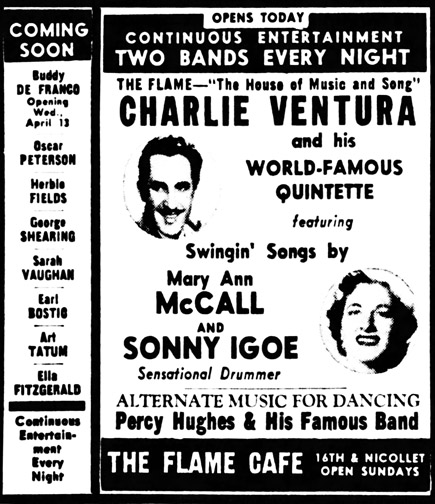
Minneapolis Tribune, March 30, 1955
Overlapping Ventura’s stand was Mary Ann McCall, substituting for the originally-scheduled Anita O’Day. McCall sang with Ventura’s band from March 30 to April 12, 1955.
After Ventura came clarinetist Buddy DeFranco, from April 13 to 26, 1955.
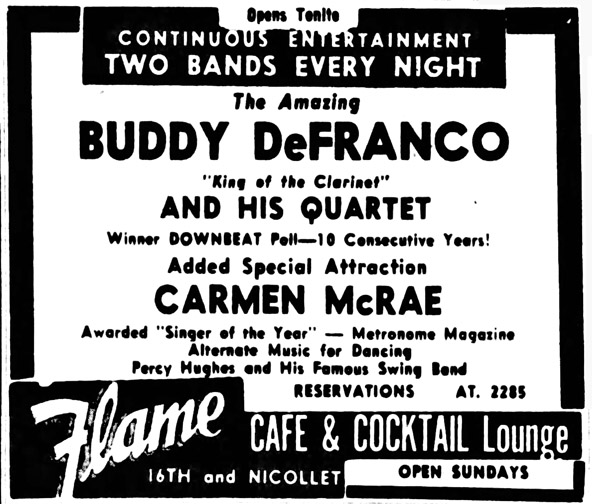
April 13, 1955
Cornet player Muggsy Spanier, the “King of the Dixielanders,” and his Sextet followed Buddy DeFranco for a week starting April 27, 1955.
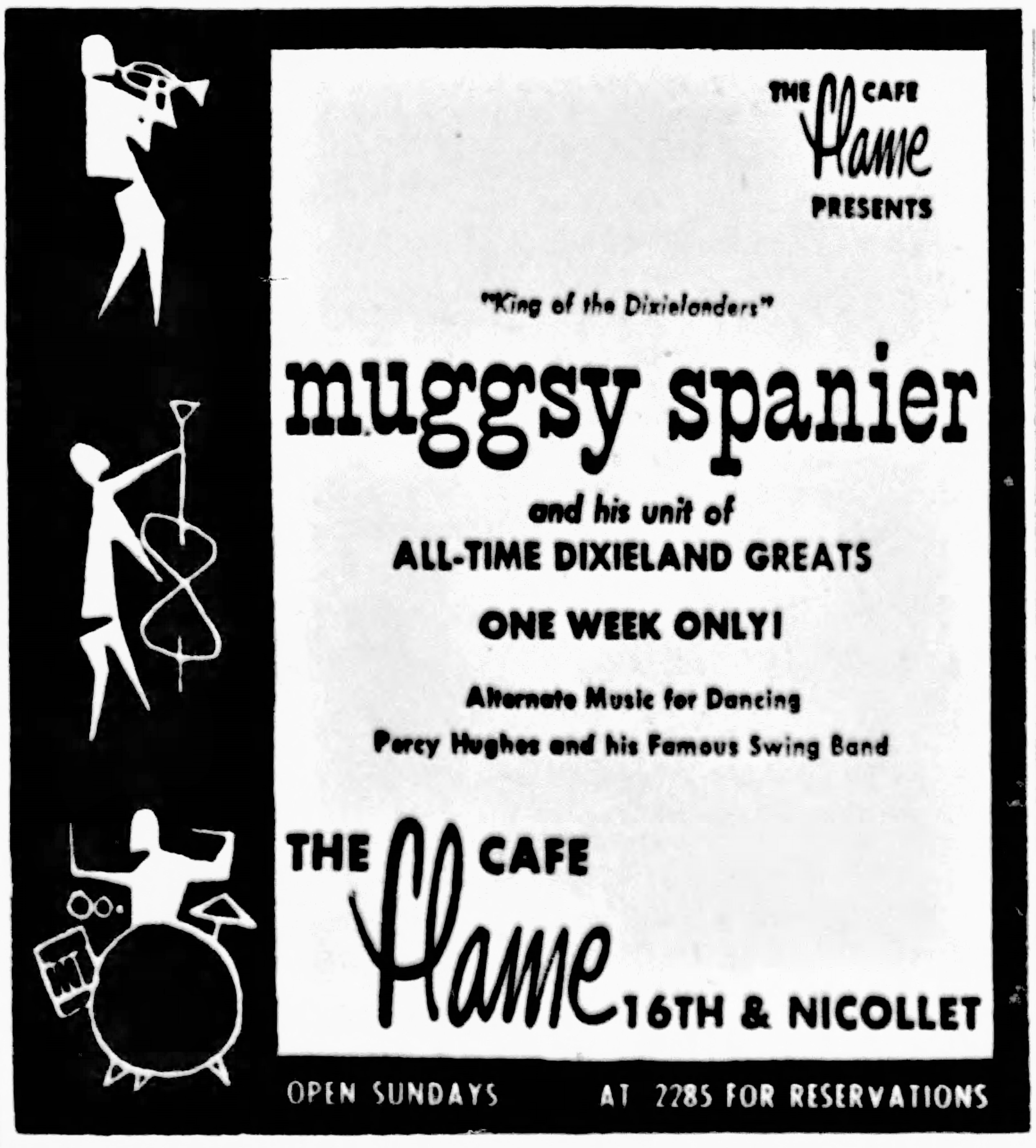
Minneapolis Tribune, April 27, 1955
Dizzy Gillespie, the “Baron of Bop,” came directly from Birdland in New York, playing the Flame from May 4 to 24, 1955. Dizzy also joined Duke Ellington at Ellington’s engagement at Northrop Auditorium on May 20, 1955. Gillespie’s band consisted of:
- Dizzy Gillespie: trumpet
- Wynton Kelly: piano
- Charles Persip: drums
- Sahib Shihab: baritone sax
- Nelson Boyd: bass
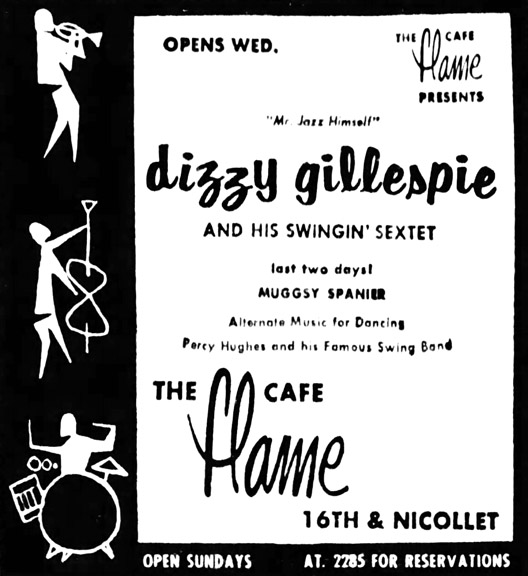
Minneapolis Tribune, May 1955
Drummer Gene Krupa and his Quartet took over from May 25 to June 5, 1955.
Then Count Basie and his 17-piece band made their first Minneapolis appearance, from June 7 – 11, 1955.
Oscar Peterson came through from June 14 to 18, 1955, with Ray Brown on bass and Herb Ellis on guitar.
Next came Sarah Vaughn, from June 29 to July 9, 1955.
Up to this time the house band had been Percy Hughes’, who also filled in on nights where no national act was scheduled. On July 10, 1955, the house band became the Oskar Nordh Trio. Nordh was on piano, Dale Olinger on guitar, and Roy Johnson on bass.
The last act that Will Jones mentioned was the Buddy Rich Quintet, on July 12 – 18, 1955. With Rich came a new jam session, scheduled for Saturdays from 3 to 5:30 pm.
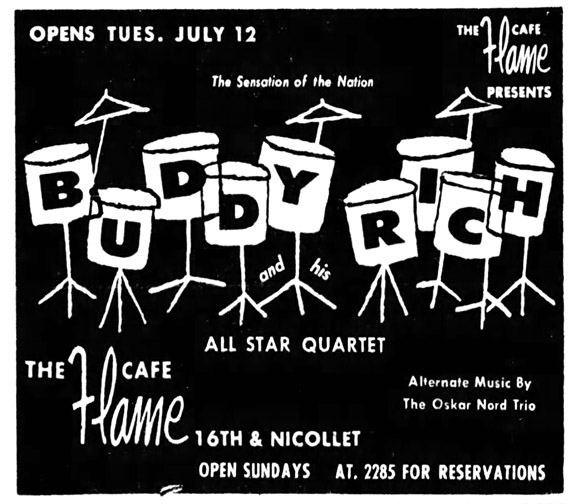
R&B saxman Illinois Jacquet began a stand on July 25, 1955.
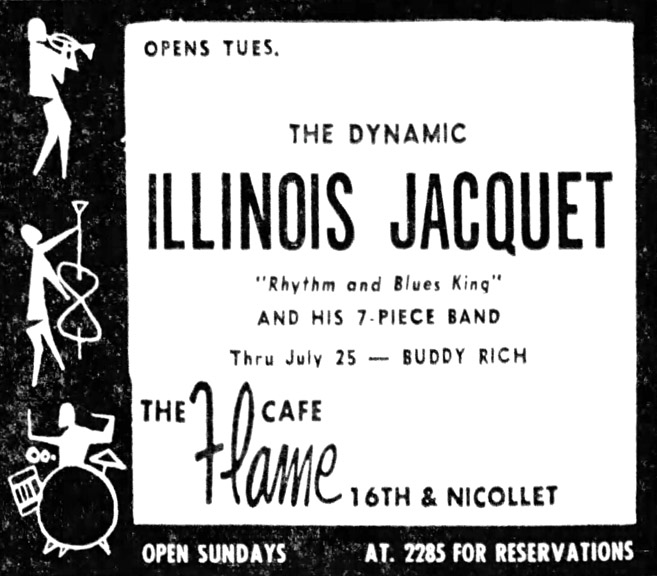
Other names mentioned during this time but may or may not have appeared are:
- Earl Bostic
- Herbie Fields
- George Shearing
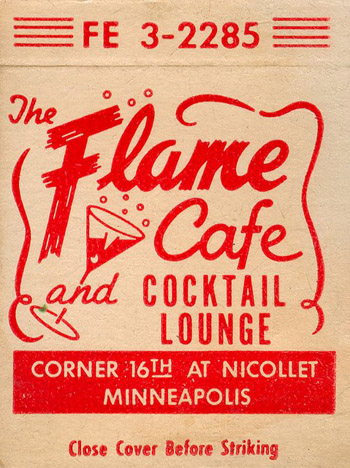
1956
THE FLAME GOES COUNTRY
In his February 1, 1956, column in the Minneapolis Star, Cedric Adams wrote:
Western music has spread out a good deal in the last few years and now it takes over a Minneapolis theater café. The Flame at Sixteenth and Nicollet experimented with a western band for a couple of nights and found the customers liked it, so now makes it regular policy. Johnny T and the Tennesseans, one of the top country and western bands, moves into the place tonight and square dancing and other hoppity steps are the rule. The Flame goes whole hog on the theme, using the Dakota Roundup troupe in the lounge, with special Wednesday night appearances by Texas Bill Strength, the hillbilly singer. Any square dance group, incidentally, can bring its own caller along, so you may hear some verbal improvisations.
On February 2, 1956, Will Jones also noted the Western trend:
Western music has been a feature of the front bar for a number of years, but it didn’t invade the big back room until last week. The management tried out Johnny T. and his Tennesseans, liked them, and hired them as an every-night attraction.
The Dakota Roundup continues in the front bar, with Texas Bill Strength as a regular Wednesday night guest.
“The Flame has become House of Western Swing – Newest Musical Fad!”
To celebrate the new musical policy, the Main room was redecorated with wagon wheels and the banquettes were covered with cowhide.
THE NEW DECOR
The photo below is of singer Dick Van Dale and local songwriter Bud Auge. It gives us a peek into the inside of the Flame in March 1961. A 1977 article describes the incongruity of the Country decor, still intact while the Main Room has turned into an R& B venue.
Cut-out figures of cowgirls wearing transparent shirts while roping cattle circle the walls. A large oil painting of an Indian shooting a buffalo hangs over the front door. Huge wagon-wheel chandeliers hang from from the ceiling.
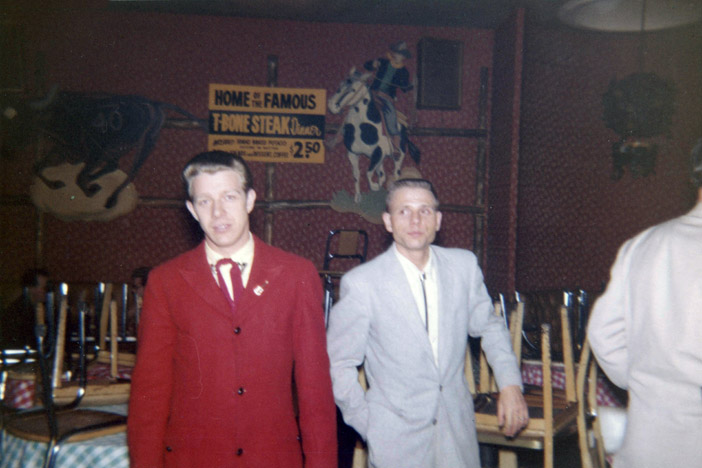
March 3, 1961
JIMMY AND ARDIS WELLS
From the time the Flame went Country, two acts were regulars in the Front Room Lounge: Ardis Wells and Her Rhythm Ranch Girls and her husband Jimmy Wells and the Dakota Roundup. Ardis Wells had an interesting life prior to her stint as a Country music bandleader.
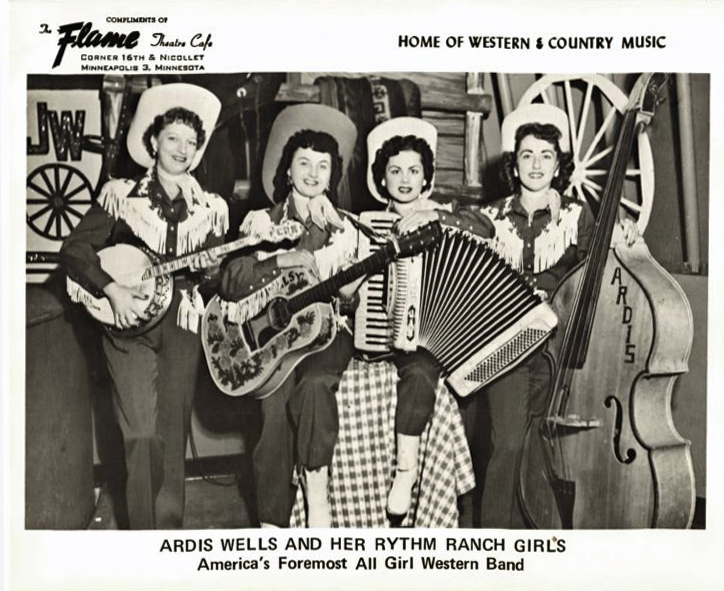
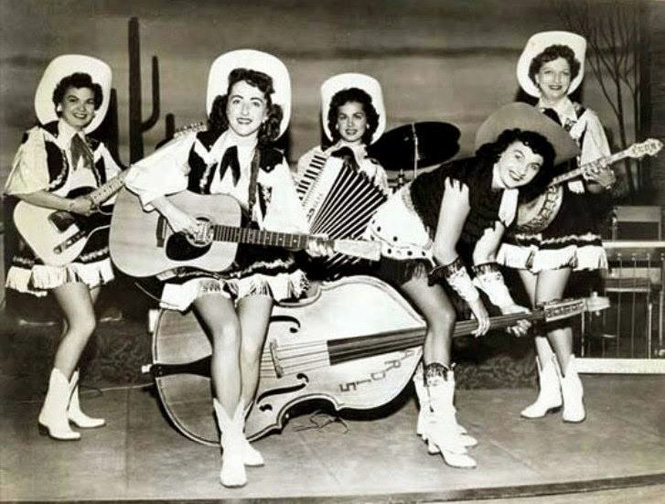
COUNTRY SHOWS AT THE FLAME
Although not complete, here is a SPREADSHEET that I hope lists most of the country performers who came to the famed Flame Cafe. TBS is an abbreviation for Texas Bill Strength, who played an important role in bringing big Country acts to the venue. Click on his name above for a much longer piece on this local singer, DJ, recording artist, and more. Additions to the spreadsheet are welcome!
The ad below may be for one of the first all-Country shows at the Flame:
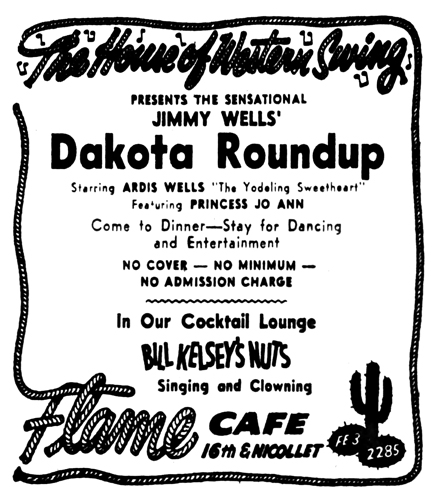
February 2, 1956
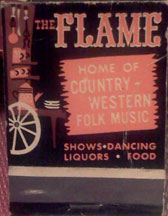
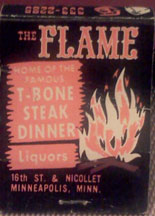
March 17, 1956, Billboard:
Jimmy and Ardis Wells and their Dakota Round-Up continue to hold forth at the Flame Supper Club, Minneapolis, where Johnny T. and His Crazy Tennesseeans carry on it the club’s rear room each Friday and Saturday night. Texas Bill Strength, now spinning the country wax over a Minneapolis station, appears as guest with Jimmy and Ardis each Wednesday night. The Flame devotes two nights a week to country music exclusively.
April 14, 1956, Billboard:
Ardis Wells and her all-girl band, the Rhythm Ranch Queens, has opened in the front room of the Flame, Minneapolis, with Jimmy Wells and the Dakota Round-Up Gang holding forth in the Flame’s rear room. Texas Bill Strength (Capitol) is a nightly guest at the spot.
TEX RITTER STARTS THE BIG NAME COUNTRY ERA
On May 10, 1956, Will Jones announced the addition of national Country stars to the Flame:
Tex Ritter, singing cowboy, will be the first of a string of western names to be booked into the Flame Café. He will appear there next Wednesday night. [May 16, 1956]
On later Wednesday nights the spot will offer Tabby West, Betty Foley, Marvin Rainwater and Bobby Lord – all of whom I have been assured are big names in the western music field. (Ritter I’m sure of, largely because of “High Noon.”)
On nights other than Wednesday, the Flame is still all-western, with Ardis Wells and the Rhythm Ranch girls in the front bar, and Jimmy Wells and the Dakota Roundup in the back room.
In reviewing the Tex Ritter show, Will Jones reported that Ritter did his show in the Main Room, then moved to the Front Room, where the crowd was a little livelier, and did a little whooping for them: “Rye whisky” “Whoooo-whoooo! Saaaaah si bon! Hubert Humphrey!” Jones noted that the Ritter crowd spent more than the packed opening-night crowds for either Count Basie or Sarah Vaughan, sealing the Country deal. Also on the bill was Texas Bill Strength. Look for the phone number in the cactus! (Minneapolis Tribune, May 21, 1956)
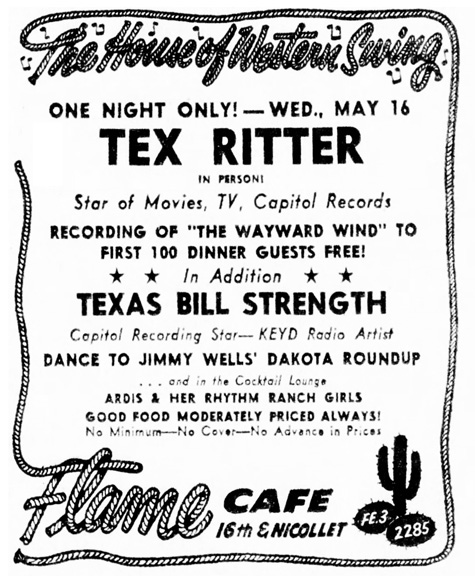
Minneapolis Tribune, May 1956
TEXAS BILL STRENGTH
Before Texas Bill came to Minneapolis for his job as a disc jockey in 1955, he had been all over the country, performing and recording. This included performances at the Grand Ole Opry, where he met many Country singers and groups. With these connections, he began to book the Flame with performers, who were attracted to the venue, but were also enticed by Bill’s descriptions of Minnesota’s hunting and fishing opportunities. Bill brought in many of the big names that came through the club, performed at the club, and also acted as master of ceremonies.
In an article in the (Nashville) Tennessean, it was reported that the country acts were booked by Lucky Moeller of the Jim Denny Artists Bureau. (February 12, 1961). In 1967, Raye Perkins told Billboard magazine that in 1956, he and Abe contracted with Lucky Moeller in Nashville to handle all the bookings for the club. This may have been true after Texas Bill disassociated himself with the club, a faulty memory, or antipathy towards Bill, but it is known that Texas Bill was personally responsible for bringing in many of the acts that established the Flame as a popular Country venue.
THE JUMPING COWBOY
Sharing the stage with Strength in September 1956 was Kenny Roberts, who appeared on September 12 through 15. Will Jones said that Roberts was a yodeler with several nationwide hit records.
His favorite trick, however, is leaping into the air, while playing guitar and harmonica at the same time, which gave him the nickname of “The Jumping Cowboy.”
Someone who knew him said he was a really nice guy.
1958
I couldn’t find a date or an ad for this show – Flame ads are notorious difficult to find, as they are literally written in a rope font, as well as many others! But here’s a photo of a Little Jimmie Dickens Show from 1958.
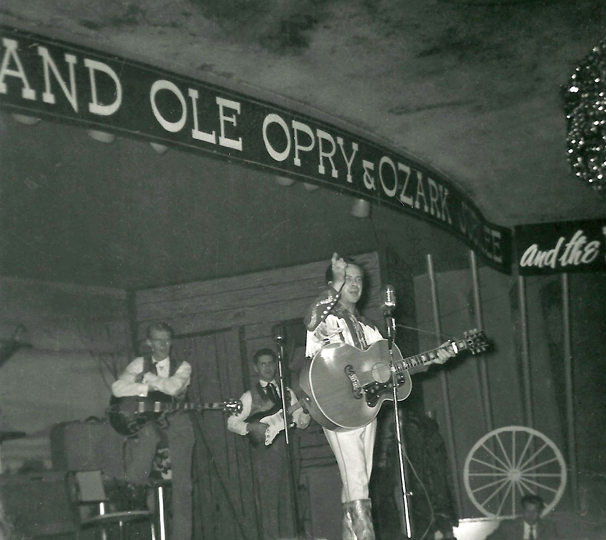
Photo Courtesy Gary Schwartz
1959
Carl Perkins appeared at the Flame on April 1 – 4, 1959, and Will Jones caught one of his performances: (Minneapolis Tribune April 6, 1959)
At the show I witnessed, Perkins wore a pink satin dinner jacket with lace lapels and cuffs, and a lace shirt. His black pants had a pink stripe. … The huge dining room was packed with country-western fans Saturday night [April 4], and there was a mob waiting beyond the ropes to get in.
Jones said this about the Flame’s strategy:
The flame uses a booking trick to keep the country-western customers stirred up: instead of bringing in a headliner for a week or two and milking his popularity, they book him for four days. The crowds come and a few get turned away. Then in about four months, they bring him back again and start the excitement all over.
1960
Below is a look at the rear of the building in April 1960. The circles indicate bullet holes!
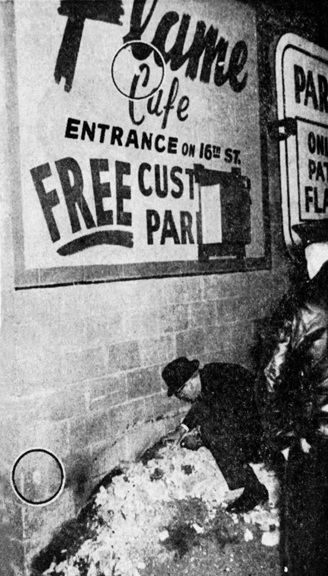
1961
KID CANN SAYS GOODBYE
By the way, if Kid Cann was still hanging around the Flame, that ended in 1961. He had been convicted of white slavery (bringing a woman across state lines for immoral purposes) in 1960, and got two years for that. In 1961 he was embroiled in a trial in which he was accused of Federal liquor violations. He was convicted and proceedings were underway to deport him back to Romania, but he got off on that. What he didn’t get off on was trying to bribe a juror, for which he got five years and a $12,500 fine. He was put in the Ramsey County Jail on March 30, 1961, which is where and when he started serving his 1960 sentence.
He got sent to Leavenworth for the first three years of his combined seven year sentence, and then to a medical center in Springfield, Missouri, because of a bad heart. In August 1964, his incredibly understanding wife, Lillian, paid his fine, and he was paroled after serving about serving about half his time on September 16, 1964. (Lillian’s address was given as 5900 Oakland Ave. in Minneapolis, where they had lived since 1952.) One of the conditions of his parole was that he was not allowed to return to Minneapolis to live. He settled in Miami, where he had amassed a lot of property. He died of heart disease on June 21, 1981, at Mt. Sinai Hospital in Minneapolis. He is buried at the Adath Yeshurun Cemetery at 56th and France Ave. in Edina (Row 1, Section 3).
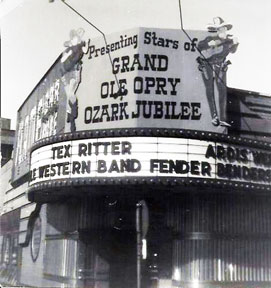
April 1961 Photo by Sherwin Linton
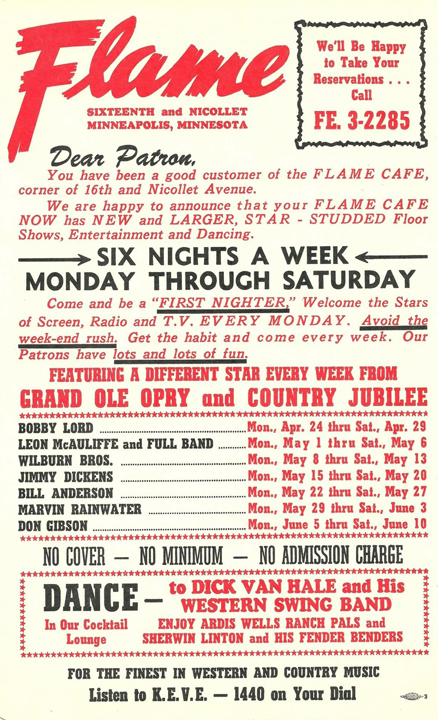
1961
FLAME RECORDS
Somehow in 1961, the Flame got into the record business! But as far as anyone knows, including the family, there were only two 45s issued. The first, put out in 1961, was by an appropriately-named chanteuse named Diane Flame, with accompaniment by Little Leon Ulrich and “Be Bop” Feathers. Diane’s musical offerings were:
- Cold Cold Heart, the Hank Williams standard, and
- My Shoes Keep Walking Back to You
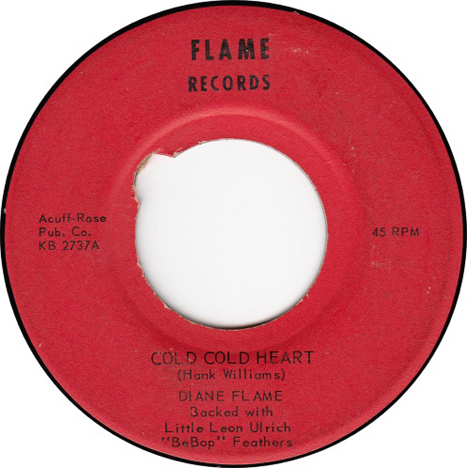
Image courtesy 45Cat.com
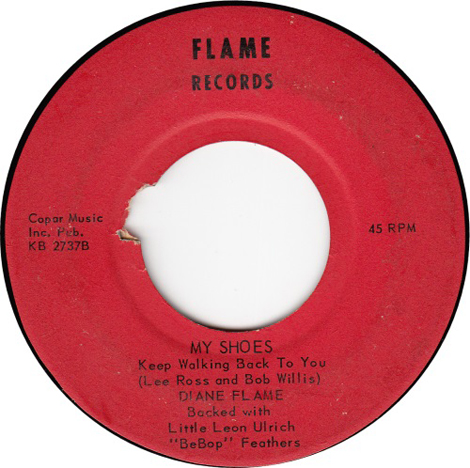
Image courtesy 45Cat.com
Jump forward to 1972 or 1973, and another 45 emerges from Flame Records. This one is put out by one Mary Beth – it’s almost as if these women wanted to remain anonymous! Mary Beth’s two songs were:
- Your Sweet Love, and
- You Should Live My Life, produced by none other than Abe Perkins himself!
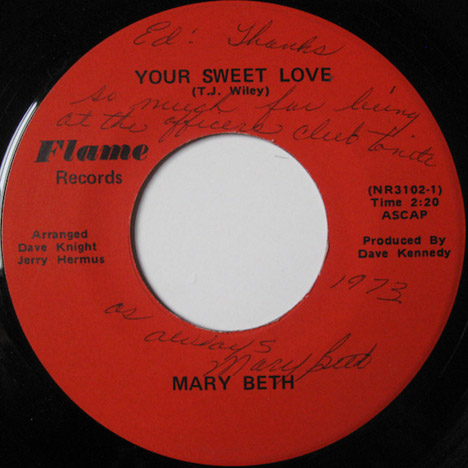
Autographed copy from Discogs.com
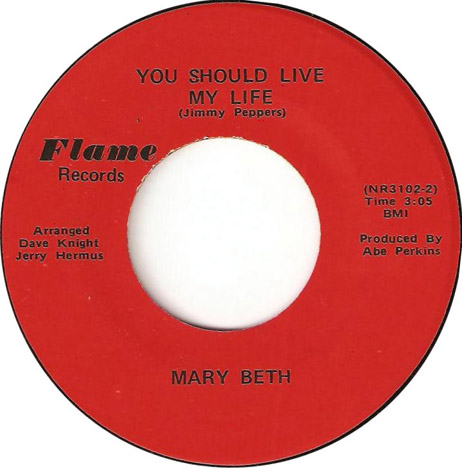
Image from 45Cat.com
If anyone knows any background on Flame Records, please Contact Me! Thanks! And thanks to record collector Derik Olson and Abe’s grandson Marc Percansky for assistance with this mystery!
1962
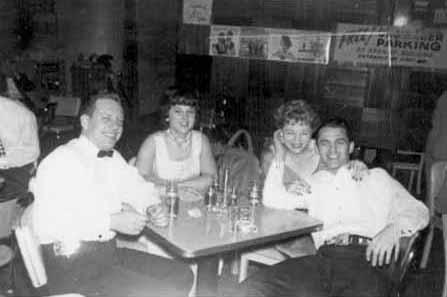
Jimmy Jensen, ?, Fern Dale, Benny Heilman in the Lounge, late 1961/January 1962. Photo courtesy Brett Williams
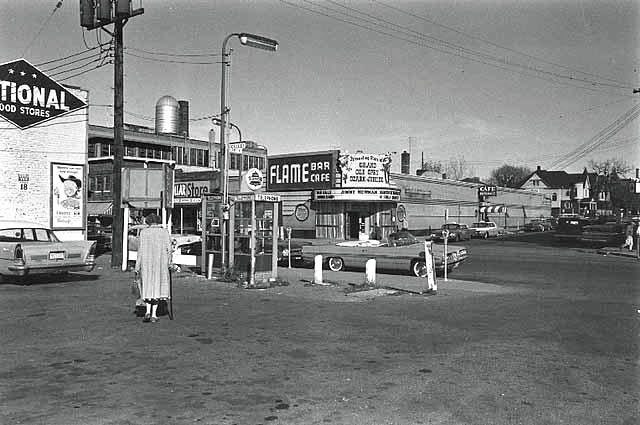
1962 Photo courtesy Minnesota Historical Society
1963
An obituary for Harry W. Beell identifies him as manager of the Flame Cafe for ten years. He was the brother-in-law of Ray Perkins.
The stories about the Flame are many and often hilarious. The following remarks are from Sherwin Linton, from an interview in Metro magazine:
Webb Pierce drove a Pontiac Bonneville with silver dollars attached to it and parked it on Nicollet Ave. with the top down while he played his shows. People would stop and look at it but didn’t bother it.
It was a nationally-known place; every week Billboard and Variety magazines would write about what was happening at the Flame. National talent agents would come in there and national critics as well. Sports personalities and other people would hang out together. They had this $2.50 T-bone steak dinner, which was at that time a very good price. Most places would charge five bucks for a steak at that time. It was a kind of place where the middle class – and even somewhat rednecks, so to speak – could hang out. But professional people and the affluent also went there to let their hair hang down. The other people went there to put on the dog. They all co-mingled with no problem at all.
1964
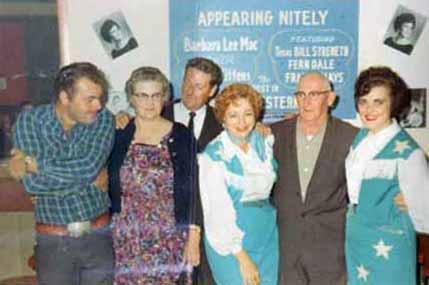
Fern Dale and Barbara Lee Mac posing with fans, @ August 1964
HOOTENANNY JAMBOREE
Here’s an item of no importance, but Will Jones devoted his entire column to it in the Tribune on September 14, 1964, so let’s give it a go.
Seems there was this chap from North Carolina named Riley Cooper who had this idea to put together a daily Country radio show on 18 Minnesota stations. It would be called “Hootenanny Jamboree,” and emanate from the Flame from 1 to 3 pm. Each show would feature whichever name performer was at the Flame that day, with 20 musicians for each show. Cooper, described as a “country-western performer, songwriter and publisher, would function as producer, master of ceremonies and resident star.” KTCR would be the Twin Cities outlet for the show. There would be a new sponsor ever 15 minutes.
Well, other than this initial article, nothing comes up in a search for “Hootenanny Jamboree,” and the only Riley Cooper in town was a basketball player. Oh well. Best laid plans.
1966
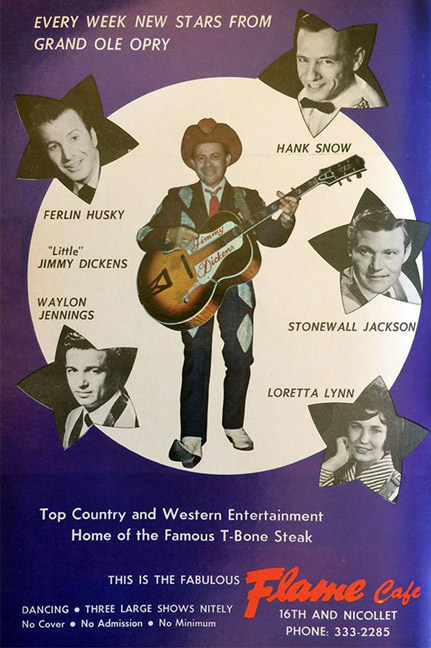
Poster from 1966 – or 1969?
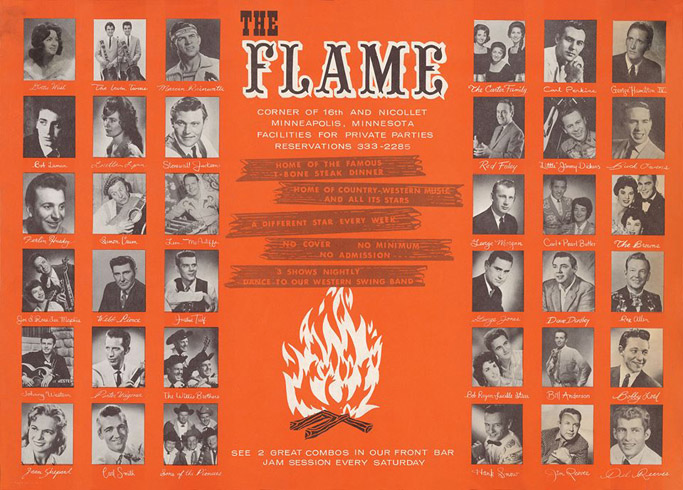
1969
In 1969, Will Jones reported a rumor that the Flame would move from Country to hard rock in its Main Room, but said that even though the move had been considered, the plan had been abandoned. The problem wasn’t that Country music was waning in popularity – on the contrary, it was bigger than ever, with “Hee Haw” and the “Johnny Cash Show” hitting the airwaves. This led to the stars pricing themselves out of the Flame’s budget, and week-long engagements were no longer feasible. Owner Abe Perkins speculated that he would only be able to bring in big names twice a month, and then only on weekends. And with those shows, he may have to add a cover charge, which patrons in Minneapolis were not used to. (Minneapolis Tribune, June 19, 1969)
High talent costs still vexed the Flame, as Country music got more and more popular and acts that used to work for $600 to $800 a week now demanded $5,000 a night. Others doubled their rate, according to Will Jones in February 1970. In response, the Flame went to a local-band only policy. Then they briefly tried bring back big names for split weeks, but the entertainers wanted more for three nights than they used to get for six, so the local band only policy was resumed. (Minneapolis Tribune, February 8, 1970)
High talent costs were not the only problem at the Flame. Abe remembered in 1977:
“People are not as orderly as they used to be. Up until 1968, I used to work this place alone with two women hostesses.” Now Abe needs three bouncers to work the floor after 6 pm. They often used to be off-duty cops, but the police department has declared the Flame off-limits because too much “rough stuff” goes on. A Flame bartender was shot and killed there [in 1975]. (Minneapolis Star, May 12, 1977)
1970
Will Jones reported that in order to get around the high cost of talent, the plan was put in place to bring in big name acts only every other week. (Minneapolis Tribune, February 8, 1970)
1972
HAWAIIAN FEMALE IMPERSONATORS?
On June 26, 1972, Will Jones reported that starting that week, the Flame was going out of the country-western business. There were too many Country bars, and the best-known entertainers had priced themselves out of the market.
So Abe and Ray Perkins went to San Francisco, looking for a new direction. The result was a production called “Hawaii Today,” sub-billed as “The Third Sex.” Some of this is repetitive of the description below, but is too funny to be believed:
There’s a chorus line of six fellows, the Pearls of the Pacific, who do girlie-show numbers in Hawaiian, Samoan, Tahitian, New Zealand, and Japanese styles.
Headliner of the show is an entertainer billed as Prince Hanalei, whose gender the Perkinses hesitate to label. The Prince’s specialty act includes walking on fire and then standing on his head with burning tassels attached to his buttocks, twirling the tassels through manipulation of his gluteal muscles. There’s a stripper billed as Sabrina.
In July 1972, Will Jones reported that the Flame had converted its Main showroom into “Paradise Isle,”
with bamboo on the walls and a setting of fake volcanic rock and tropical greenery on the stage. Six of the most stunning showgirls you ever saw slink and prance through Polynesian flavored production numbers, and if they’re not really girls but guys who like to dress that way (the only giveaway is their big feet). Well, that’s showbiz. They’re beautiful.
And the country touch isn’t that far away, either. The Chill Hilmin band still plays in the front bar. And when, in the backroom, The Hawaiian Expression gets going on a New Zealand number to back up the dancing, the yipping and the yahooing from the band are like echoes from the past.
After having printed some advance word on Prince Hanalei, the headliner, who walks on fire and then stands on his head and twirls flaming tassels attached to his bare buttocks, there isn’t much more to say. Except that, now that I’ve seen it, I can add that, yeah, he sure does all that stuff. And with style.
Another headliner is Macey Williams, who functions as comic, singer and emcee. He makes a very funny business out of singing “My Way” as he puts on his full drag costume, piece by piece, in full view of the audience. There is also something hilariously inappropriate about his appearance in a geisha costume to sing “On the Street Where You Live.”
It’s a lively, flashy, well-staged production that goes on for about 90 minutes, with excellent backing by The Hawaiian Expression. If there’s such a thing as Polynesian rock, that’s what they play. (Minneapolis Tribune, July 6, 1972)
This new feature started on June 29, 1972.
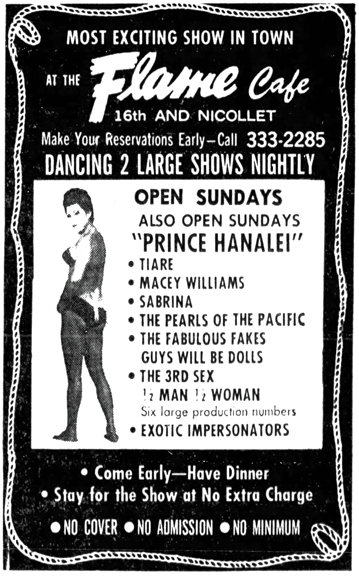
Minneapolis Tribune, July 2, 1972
1973
March 10, 1973: After discontinuing its country format a year ago, the Flame reverted to form and began bringing in big name country performers again. There are now two full-time country house bands: Texas Bill Strength and his group in the front lounge and the Chill Hilmin Country Show in the Main room. Part of the renewed interest can be attributed to the addition of an all-night country show on KTCR-FM with Gregg Elsworth. KSTP AM also has a midnight to 6am country show directed specifically at truck drivers and other night people, hosted by Al Carlson. (Will Jones)
R&B AND COUNTRY
The all-country format apparently didn’t work out, and drastic changes were made. It’s been a little difficult to pin down what went on in the ’70s, but I’ll put down what I have. Thanks very much to my Facebook Friends and musicians for their help!
COUNTRY IN THE FRONT
As far as I can tell, there continued to be Country bands in the Front Bar, perhaps until the very end in September 1978. There was a sighting of Little Jimmie Dickens’ motorhome on his way to a gig in 1978, so that may be a clue.
GETTING ALONG
There was a hallway from the front Country bar to the back Main room. Mixing Country and R&B seems like a recipe for disaster, but it seemed to work. Bobby Vandell, drummer for the funk band Our Father’s Children, explains:
As you can imagine, the patrons were mixed to say the least, and they shared the same bathrooms with very few incidents. I always felt comfortable there – of course all the Brothers and Sisters dug me cause I was the funky drummer. It didn’t hurt having an afro bigger than anyone.
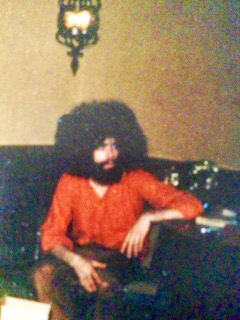
Bobby Vandell’s ‘Fro
THE ZODIAC ROOM
The Main Room became the Zodiac Room, the home of Rhythm and Blues. The local bands who appeared in the Zodiac room included:
- Band of Thieves
- Flight Tyme (precursor to the Time)
- Willie and the Bees
- Scorpion (“kind of a velour funk band,” says member Hearn Gadbois)
- Haze (perhaps)
- The Lake Street Stink Band, a blues band Gary Schwartz was in, played the main room in the mid-’70s.
- Our Father’s Children, with Bobby Vandell
THE PHILADELPHIA STORY
Perhaps the biggest local name was the Philadelphia Story. The group started as the Val-Dons, while the members were in the Navy in Pensacola, Florida, in 1968. When they were discharged, they eventually regrouped in Minnesota, Where they changed their name to the Philadelphia Story.
They were a singing group, and would hire a separate instrumental group to back them. According to Robb Henry, who worked for them for the summer of 1975 in the Storefront Band, the Philadelphia Story was very professional, giving out paychecks, taking out taxes, and expecting regular rehearsals.
Below is the Philadelphia Story: Monroe Wright III – William H Clark – Maurice W Young – Clifton Curtis Jr.
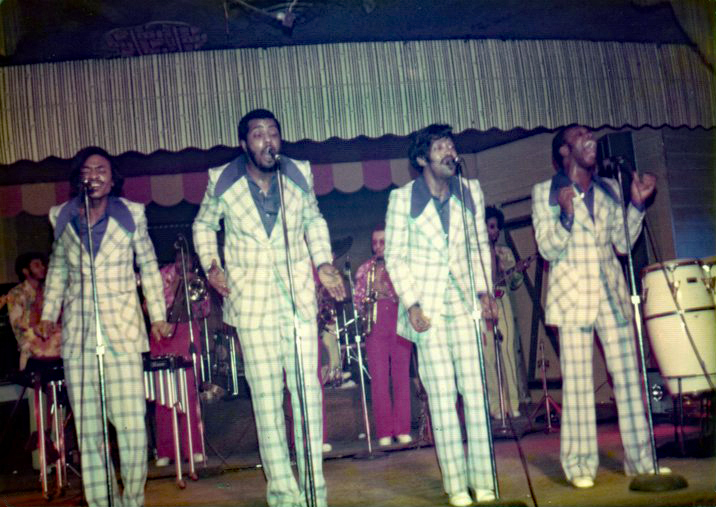
Photo courtesy Monroe Wright III
1974
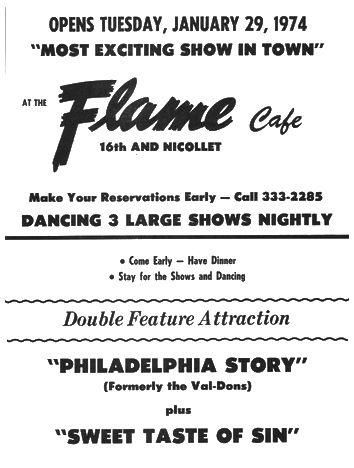
January 1974. Ad courtesy Monroe Wright III
Another regular band that backed up the Philadelphia Story was the Sweet Taste of Sin. At some point the two units merged into Sweet Story.
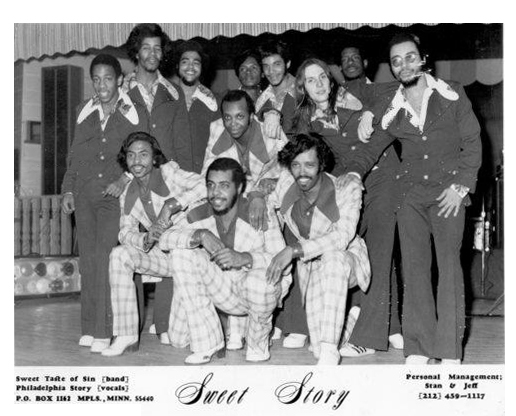
Photo courtesy Monroe Wright III
Sweet Story played the Zodiac room several times circa 1974/1975.
1975
DAVID RUFFIN
Seth Schwartz of the Minnesota Daily reported that the Flame was starting a six month trial period of bringing in nationally-known black performers. The first of these was David Ruffin, former lead singer of the Temptations. Ruffin performed in the Zodiac Room July 1 through 6, 1975. The show was opened by local vocalists the Philadelphia Story, and musicians the Storefront Band, featuring our own Robb Henry, who got a great review. Schwartz was not impressed with Ruffin’s own band, the Ruff-Riders. KUXL Disc Jockey Pharoah Black was the Emcee of the show. (July 11, 1975)
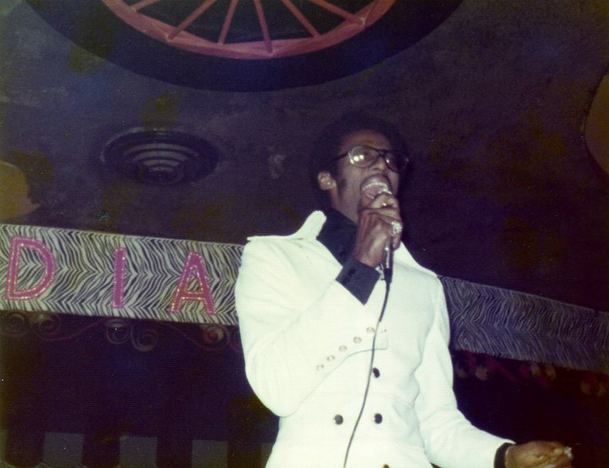
Photo of David Ruffin courtesy Monroe Wright III
EDWIN STARR
Another National Act was Edwin Starr. Starr’s biggest hits on the U.S. Pop and R&B charts were:
- Twenty-Five Miles (#6 on both charts) 1969
- War/Stop the War Now (#1 Pop, #3 R&B) 1970
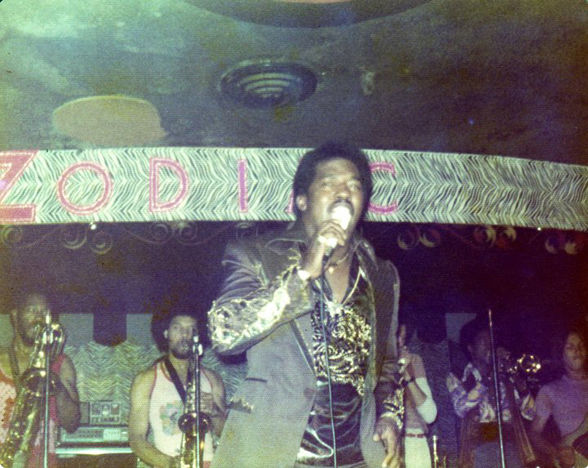
Photo of Edwin Starr courtesy Monroe Wright III
The Sweet Taste of Sin was at the Flame in October 1975.
On December 8, 1975, a bartender was shot two times at about 9 pm and died at HCMC on December 9, 1975. (Minneapolis Tribune, December 10, 1975)
1977
The Main room was described as a disco in a Minneapolis Star article.
Spotted in the TV listings: A show on Channel 2 called Wyld Ryce called New Year’s Musical Pilaf on December 30, 1977, with:
- The Reginald Buckner Quartet
- Danny L. and the Brewerettes
- The Chill Hilmin Country Show, featuring Kim Martin
- Hosted by Pharaoh Black, DJ at KUXL
This just HAS to have been taped at the Flame, don’t you think?
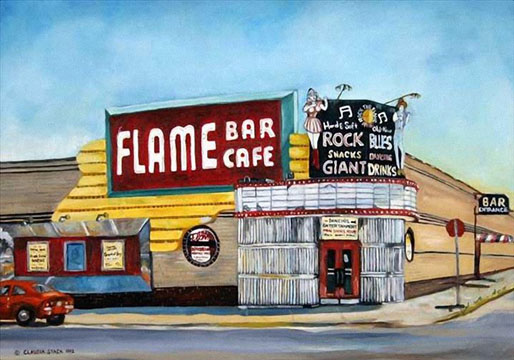
Painting by Claudia Stack
1978
THE FLAME GOES OUT
During the first six months of 1978, 25 people were arrested at the Flame for prostitution.
In June 1978, police arrested the “King of the Pimps,” who called himself Cassanova, at the Flame. He allegedly had pimps working for him. Kind of a Pyramid Scheme for pimps.
In July 1978, a City Council committee recommended that the club’s liquor license be revoked for prostitution. While filming a story at the bar about the decision on July 1, WCCO-TV cameraman Robert Cowan was attacked, and reporter Karen Boros had a gun pointed at her when she tried to go for help. The attacker’s motive was that he didn’t want his picture taken, but it the whole incident was filmed, and he was caught in the act.
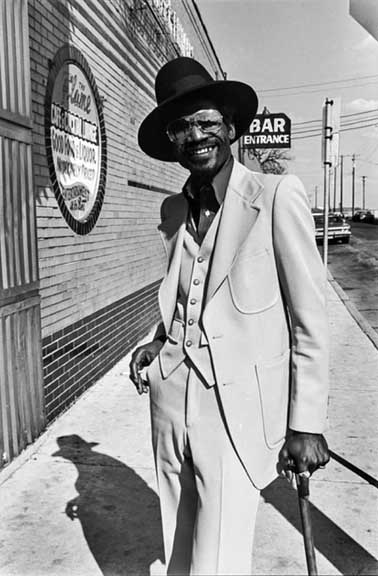
Man by the Flame, 1978. Photo courtesy Minnesota Historical Society
Under the gun from police for being a haven for prostitutes and the site of assaults, the Minneapolis City Council revoked the club’s liquor license on September 7, 1978. The decision came after two teenage prostitutes testified that they often worked out of the Flame. Abe had requested a temporary restraining order barring the City from closing the club, but the court denied it. Papers were served at 6 pm that fateful Thursday, and six minutes later, the Flame was snuffed out. Customers refused to believe it or leave until they got the word from Abe or his son Mort, and saw the news on the bar’s TV. (Minneapolis Tribune and Minneapolis Star, September 8, 1978)
At the time of closing, the sign promised Hard & Soft Rock, Old & New Blues, Snacks, Dancing, and Giant Drinks. The Marquee simply said Disco Soul.
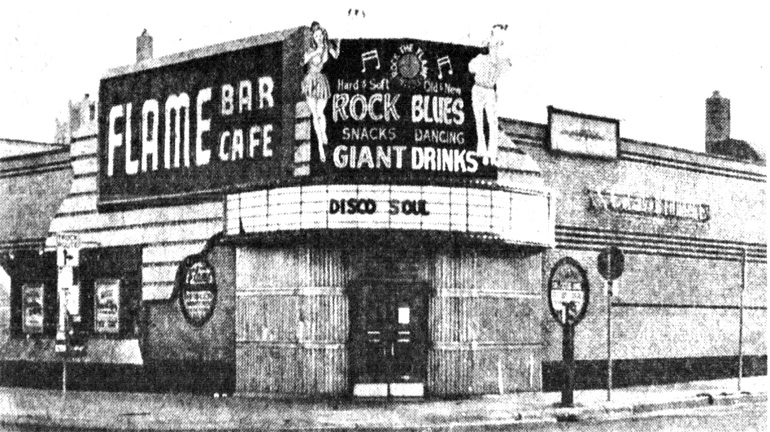
The Flame in 1978. Minneapolis Star, July 25, 1980
1979
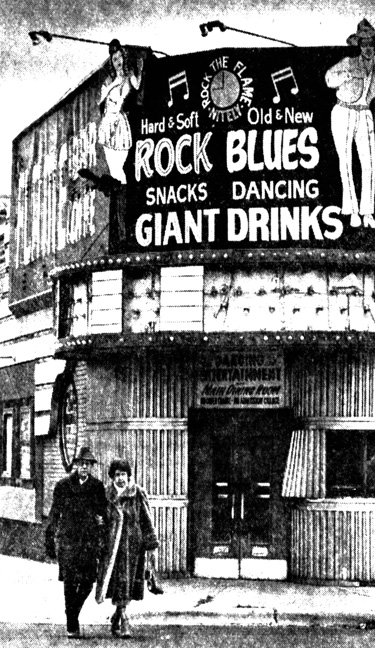
Flame Marquee in shambles. Minneapolis Star, December 3, 1979
1980
At age 76, Abe still hoped to regain his liquor license, but he filed his appeal one day too late. The Hennepin County District Court was sympathetic, but in July 1980, the Minnesota Supreme Court held that the City’s revocation would stand.
Abe died on January 23, 1985, and is buried at the United Hebrew Brotherhod Cemetery in Richfield.
1981
GREATAPES
In 1981 the building became the home of Greatapes Multimedia Company, owned by Jim and Diane Woelm. The new owners were respectful of the building’s history, and displayed photos of performers who have appeared at the old Flame that came with the building. Greatapes has now rented out the old Flame and moved around the corner.
GONE BUT NOT FORGOT
On October 15, 1995, Sherwin Linton organized a Flame Cafe Day at the Bel-Rae Ballroom, starring Hank Thompson. Sherwin and his band the Cotton Kings also performed, as did numerous local Country stars who had played at the Flame.
Jim Meyer reported in the City Pages on October 11, 1995 on some of the special guests:
- Fern Dale, the tenor banjoist who led a dazzling all-woman group in the ’60s
- Bobby and Cal Houle of the Houle Brothers
- Johnny Fields of KFAI’s Good ‘n’ Country, and a free-lance steel player known as “the mad scientist” in the old days.
- Cable-TV country VJs Viva and Jerry, who wer frequent patrons
- Larry LaPole of the Polecats
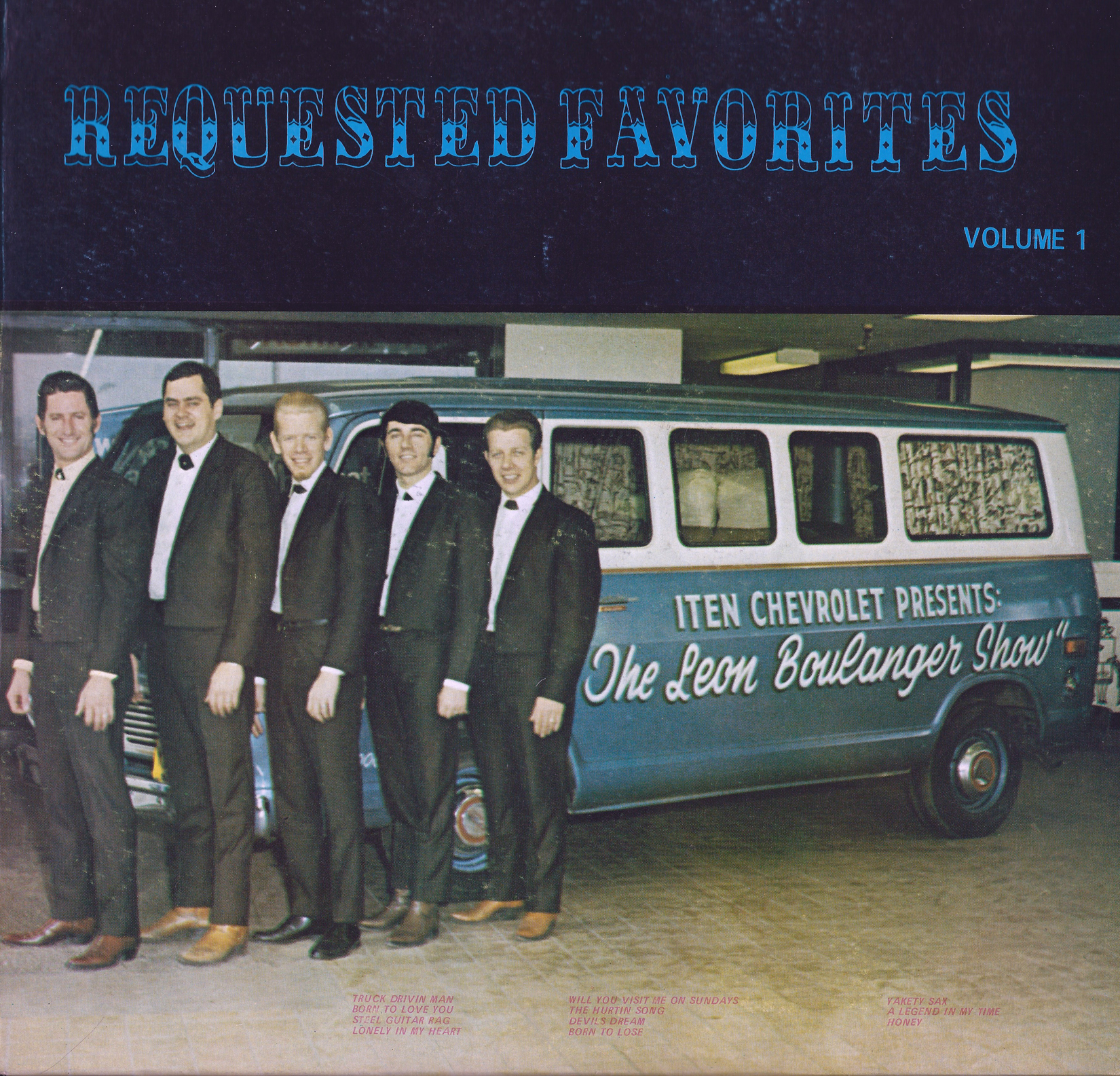
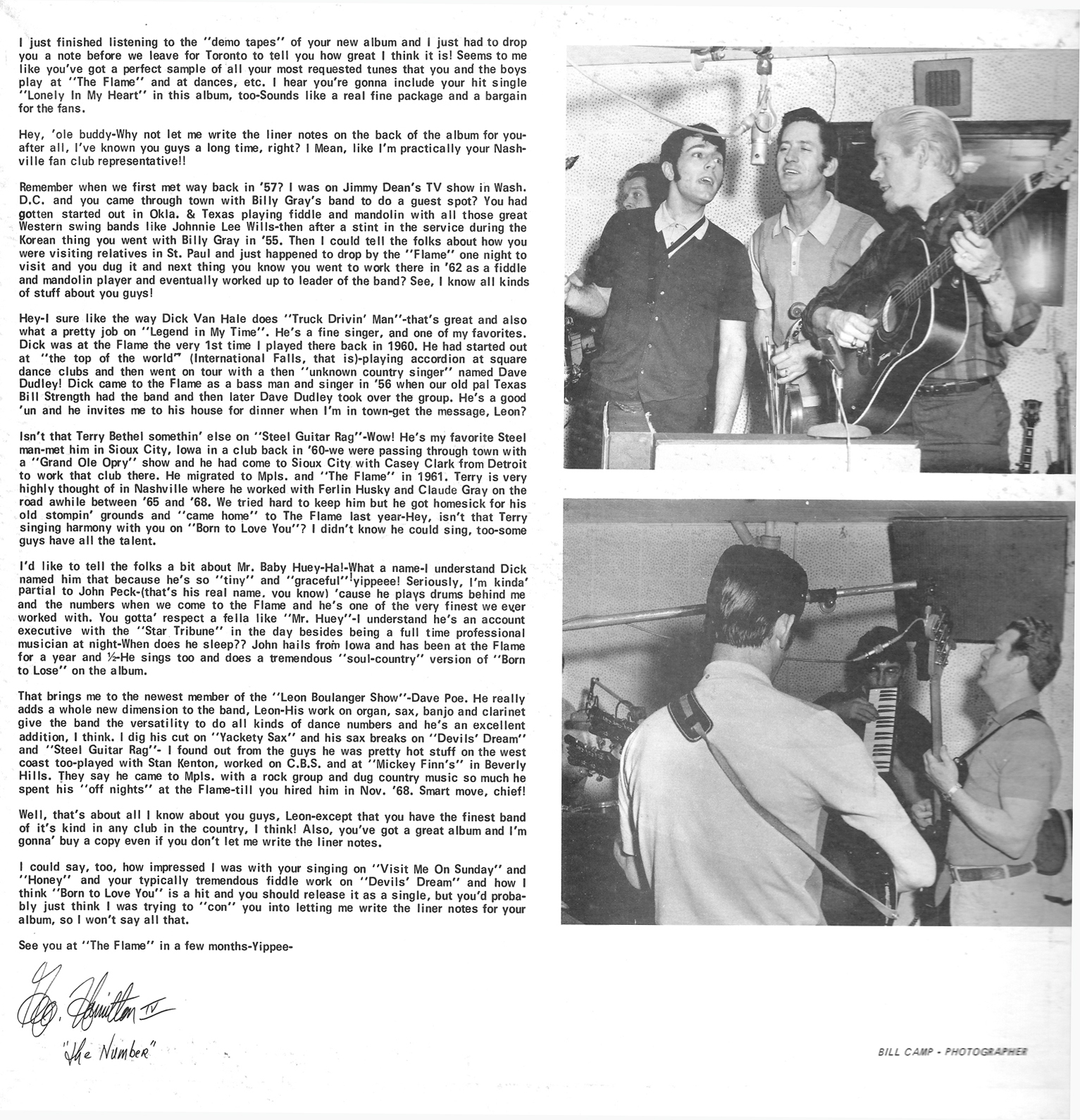
There were many clubs called the Flame, including the one on Nicollet in Minneapolis, and the Flame Room at the Radisson Hotel, also in Minneapolis.
19 E 5th STREET
This one was the Flame Jazz Club, and it was first located at 19 E Fifth (near Wabasha) in the Jewell Hotel in St Paul. The building went back to about 1895, with the hotel occupying the top four floors of the five story building
The club hosted many big name jazz acts in the early 1950s. See a collage of ads on Robb Henry’s blog. A search of the Minneapolis papers shows the following – the dates given are the opening dates as best that can be determined.
- Henry “Red” Allen, February 4, 1950
- Anita O’Day, February 2, 1950
- George Shearing, May 15, 1950
- Dizzy Gillespie, June 27, 1950
- Art Lund and Jimmy McPartland, July 24, 1950 (newly redecorated)
- Georgie Auld and His Auld Stars, August 11, 1950
At about 3:00 pm on Sunday, August 13, a six-alarm fire destroyed the Jewell Hotel, including the Flame Club.
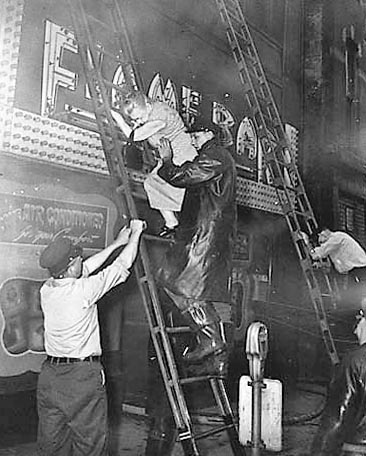
Courtesy Minnesota Historical Society
Due to the hotel’s downtown location in Victory Square, hundreds of people came to watch 27 fire companies (including six from Minneapolis) fight the blaze.

Minneapolis Star
457 WABASHA
The fire forced the club to relocate, and it moved to 457 Wabasha Street.
- Herbie Fields, February 28, 1951
- Charlie Parker, April 26, 1951
- Terry Gibbs, April 17, 1951
- Stan Getz, May 7, 1951
- Billie Holiday, August 24, 1951
- Art Tatum, August 31, 1951
- Savannah Churchill, September 14, 1951
- The Four Knights, October 12, 1951
- Red Nichols, October 22, 1951
- Charlie Barnett, October 1951
- Nellie Lutcher, November 10, 1951
- Johnny Hodges, November 29, 1951
- Viola Jefferson
In a January 17, 1952, Minnesota Daily article, jazz columnist Tom Snell notes, “The flame that once kindled jazz in St. Paul is out…. With the arrival of Frankie Yankovic and a young woman who will take off her clothes in time to music at the St. Paul Flame, the Twin Cities lost another of their traditional jazz spots. What exactly happened to the once-bright Flame is not known, but the results are self-evident – no more name talent from the outer reaches of jazz.”
The act cited may have been “Zorine, Queen of the Nudists,” which was reported to have been banned in January 1952.
TEENAGE GANGS
In February and March 1952, Harry Greene, variously listed as proprietor, operator, and owner of the bar, and two of his bartenders were put on trial for serving drinks to members of a teenage gang that specialized in robberies. A 17-year-old testified that he had been served drinks at the establishment before shooting the proprietor of the Twin Light Tavern. Greene and one of the bartenders were convicted on March 14, 1952, of selling liquor to minors. Judge James C. Otis
said he found the evidence “overwhelming.” Instead of discouraging minors from entering his establishment, Greene “welcomed them with open arms,” the judge said. The place apparently “teemed with teenagers,” the court added. (Minneapolis Star, March 14, 1952)
Sentencing was scheduled for March 19, but Greene appealed his conviction, and no action was taken on his liquor license pending the decision of his appeal.
In November 1952 a new Mayor, John Daubney, was elected, and one of his issues was shutting down the Flame. On November 6, 1952, the City Council voted to revoke the Flame’s liquor license, even though Greene’s appeal had not been heard.
THE FLAME SPUTTERS OUT
It appears that there was an attempt to revive the Flame as a jazz venue later in 1952.
- Young Moderns All-Star Jazz Group Featuring Lou Levy, July 18, 1952
- Lou Levy and His All-Star Jazz Band, September 5, 1952
- Herbie Fields, October 16, 1952
The photo below was found on Lyfmap and dated April 15, 1953. I suspect it came from the Minnesota Historical Society, but there’s no source information, or else I’m not so smart at Lyfmap. Thanks to Bill Conlan for the tip.
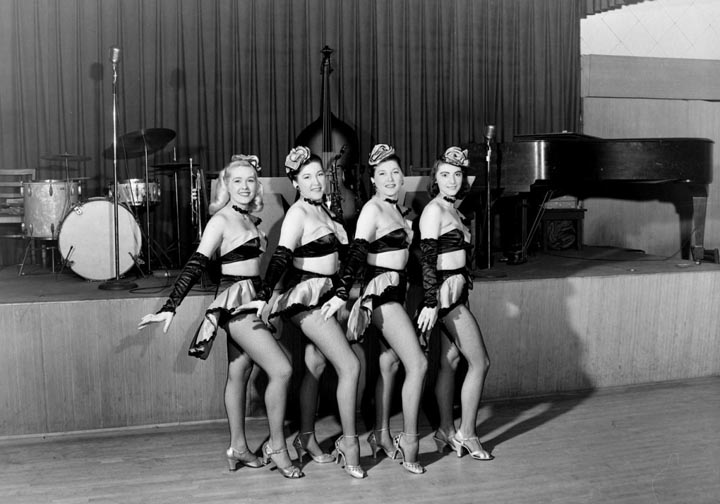
Flame Girls
Although there are no ads to be found, the Flame was apparently still burning on July 20, 1953, when a 20-year-old woman asked to try on a man’s $500 diamond ring and then took a powder to the powder room. She was caught and hopefully he was a little wiser.
A legal note in the paper dated December 16, 1955, indicated that the bar had closed in bankruptcy, but it didn’t say when.
The site became one of many locations of Alary’s.
This building at 1605-07 Nicollet began as the Gladstone Gardens. See the link for its history as the original Flame Theatre Lounge and the Hoop-D-Doo.
There were lots of places in the Twin Cities that were called the Flamingo, so it seems. I’ll put them all on this page.
665 UNIVERSITY AVE., ST. PAUL
A search for this address reveals that it was the home of Fredrick J. McGhee. At the turn of the last century, McGhee was one of Minnesota’s most prominent trial lawyers.
McGhee was born in Mississippi slaves’ quarters in 1861, just months after the Civil War broke out. He and his family made their way to Knoxville, Tennessee, after the war, where Fredrick graduated from college. He then moved to Chicago, where he worked as a waiter to pay his way through law school. In 1889 he settled in St. Paul, where he became the first African American admitted to practice law in Minnesota.
In St. Paul he became involved in national politics, first as a Republican and then as a Democrat. In 1905 he was one of a group of 32 men, led by W. E. B. Du Bois, who founded the Niagara Movement, which called for full civil liberties and an end to racial discrimination. The Niagara Movement was the catalyst for the 1909 founding of the National Association for the Advancement of Colored People (NAACP). McGhee founded Minnesota’s first NAACP chapter.
Mrs. McGhee was also a force in St. Paul. The Adelphai, a black women’s organization, formed in October 1900 with the goal of uplifting of the colored race. In March 1901 the group met at the McGhee house to form the St. Paul Chapter of the National Association of Colored Women.
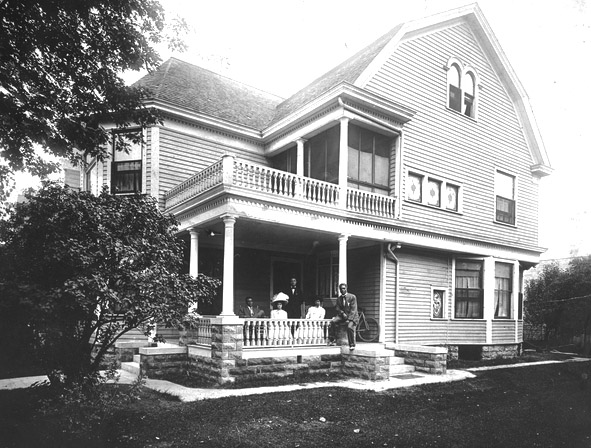
665 University Ave. in 1918. Courtesy Minnesota Historical Society
THE RED FEATHER
The building – or at least the address – became the Red Feather Buffet – evidence appears from September 1941 to November 1960.
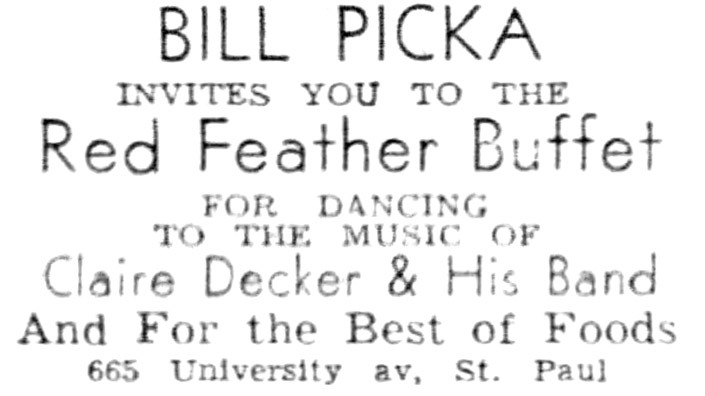
December 30, 1947
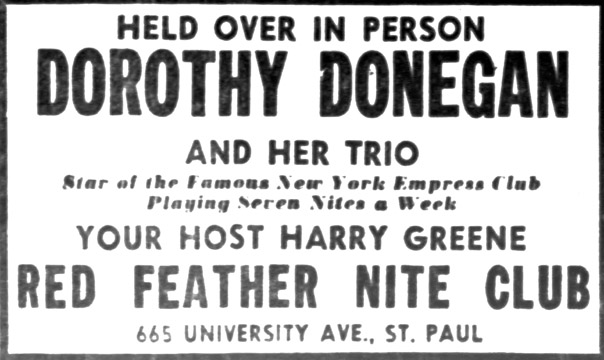
January 20, 1959
THE FLAMINGO
The Flamingo was at this address in about 1962 to 1965. In 1963 the proprietor was Frank Fabio. Ads for waitresses at this private club (all the rage then) in August 1962 required that applicants had to “be able to wear short costumes.” In April 1965 the owner was listed as Joseph Arrigoni, Jr. In September 1965, John J. Anzevino, Jr. was listed as a former owner.
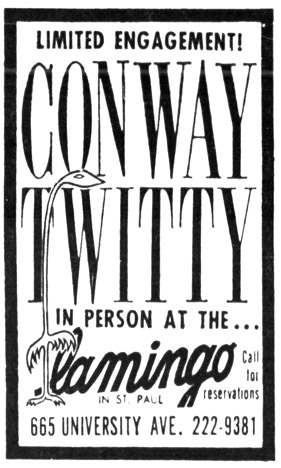
April 1, 1964
Bo Diddley (and the Dutchess) were also entertainers at the Flamingo.
THE HAREM CLUB
In the basement was the Harem Club, according to an article in April 1963.
This apparently morphed into the Black Bottom Club, a private club (Facebook Fact).
ANOKA
A different Flamingo Club was located on Highway 8 and Woodland Road in Anoka County. It opened at the beginning of February 1954. Thomas Zielen was named as the owner in March 1954.
FLAMINGOS NIGHT CLUB
This was a club in the Airport Hilton, located at 3800 E. 80th Street in Bloomington.
Don’t make book on this information because it’s pieced together from some confusing newspaper reports from the 19th Century.
Abraham Fletcher built the first Fletcher’s Hall in 1853 at the southwest corner of First Street and Second Ave So. It fronted the river, It was a two story building and the hall was on the second story. Abe was the postmaster.
The second Fletcher’s Hall opened on October 1, 1856, at Second Ave. S. between First and Second Streets. In 1856, Adelina Patti and Ole Bull appeared together in this rough building for a concert. Patti was just 13 years old, but would become the world’s most acclaimed soprano of her time.
By 1865 the third Fletcher’s Hall was on Washington Ave. So. and Third Ave. In the 1880s the Hall was used by a number of churches.
The Foo Chu Cafe was a restaurant at 4315 Excelsior Blvd. in St. Louis Park.
In February 1963 owner Jimmy Wong added a new piano room featuring veteran blues-and-bordello style pianist Frank E. Hines. Hines wrote “Physical Therapy Blues” at the Veterans Hospital after undergoing a double leg amputation.
The Foo Chu, one of the legendary entertainment spots on Excelsior Blvd., burned down in 1978.
The Ford Motor Company Union Hall was located at 2191 Ford Parkway in St. Paul.
It was dedicated on October 16, 1953. The meeting hall and office building was built at a cost of $100,000.
The hall would be rented to groups that would hold dances.
The photo below is from a dance on April 5, 1968, with entertainment by the Nickel Revolution.
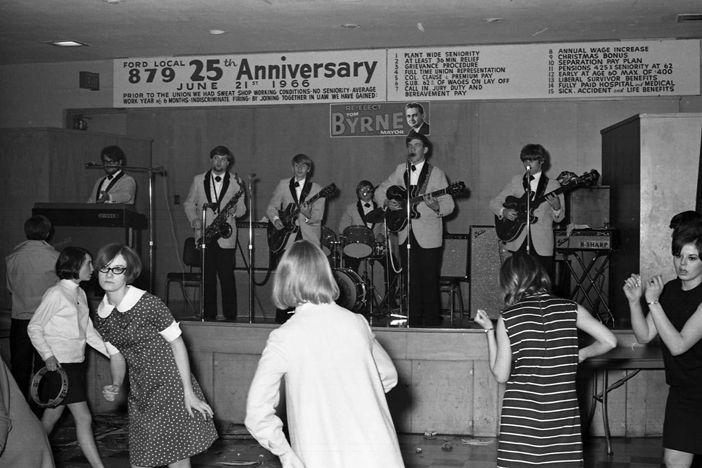
Photo copyright Mike Barich, St. Paul
In 2020 the building is Erik’s Bike, Board, and Ski Shop – they even have the building’s blueprints on the wall!
The Forsthaus (Forest House?) was at 1539 South Robert Street in West St. Paul.
1974: Featuring the Northwest’s Finest & Award Winning Entertainment! Upstairs in the main dining room: Vintage. Downstairs at the Bottom Half: Sue Drude.
Much has been written about the Foshay Tower, the first and most beloved skyscraper in Minneapolis, located at 114 So. 9th Street. I won’t go into its history here, except to say that it was built in 1929 by Wilbur B. Foshay, to emulate the Washington Monument. Brian Marsh found a photo of the bottom section in 1928, before the tower was built:
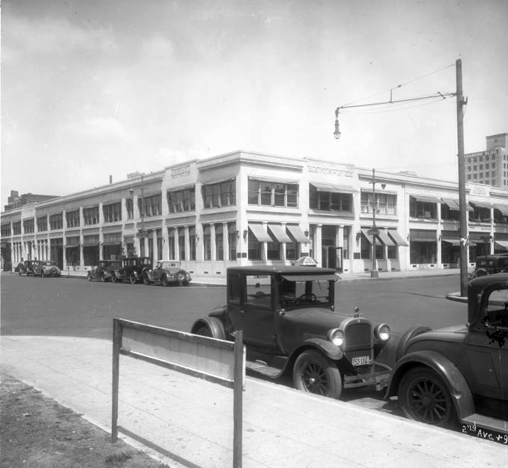
Photo courtesy Hennepin County Library
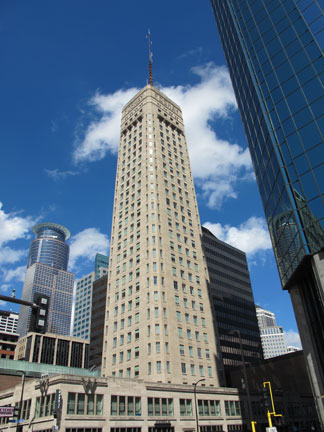
Photo from 2014 courtesy Stephen Raymer
After serving as an office building for decades, it is now a luxury hotel. Several clubs have taken a shot at the space on the first floor of this iconic building over the years.
FIVE O’CLOCK CLUB
There were Five O’Clock Clubs all over the country. Minneapolis had Five O’Clock Clubs in two locations. Not to be confused with Jimmy Delmont’s radio show of the same name on WTCN!
SKID ROW
The first Five O’Clock Club was located at 34 So. 5th Street, on Minneapolis’s Skid Row. It was one of the last of the bars to be demolished for the Gateway revitalization.
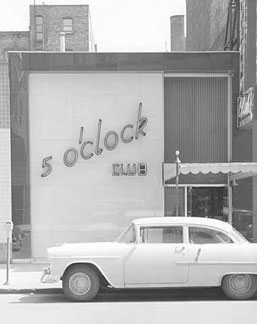
I’m guessing this is the Fifth Street location.
There was an item about two former owners being involved in a sugar black marketing scheme in 1947, but it is unclear whether they were owners of this particular club.
In 1953, E.R. Kibler of Hallet and Carey grain brokers was said to operate the club.
And in the early 1960s, Danny LaBarre and Fran Davies owned the club.
Clearance of the Gateway required the club to be demolished, and all fixtures were sold in April of 1962.
FOSHAY TOWER
LaBarre and Davies moved the club to the Foshay Tower in April or June 1963.
The Five O’Clock Club was later owned by Manny De Silva. In October 1963 Manny was billed as a popular romantic singing idol. From 1963-69 Manny sang at Ferrara’s as well.
The Five O’Clock Club was gone from the Foshay Tower by January 1965.
KING SOLOMON’S MINES
King Solomon’s Mines was owned by dance instructor Dean Constantine.
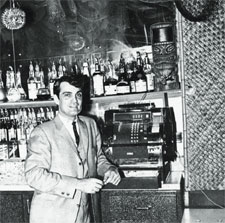
Dean Constantine. Photo from Secret Stash
FINDING ITS NICHE
The first ad in the Minneapolis papers appeared on November 13, 1966. The place started by featuring Latin rhythms. The first act was Herb Schoenbohm. Relieving him on Tuesday nights was Connie Hechter’s Afro-Cuban Sextet.
In January 1967 there was a change in Latin bands, with rotating rock bands on Sundays.
In mid-February 1967 the whole schedule went rock. A variety of rock bands went into rotation, and the Trashmen played the last two weeks of March 1967.
Photos below from Secret Stash

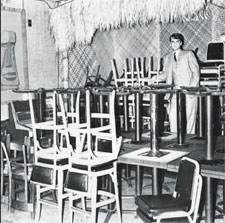
R & B DOWNTOWN
In April 1967 it began booking R&B acts, making it the only venue for black music downtown. Will Jones reported that it had had a change of management and was looking for a new name. In 1967 the club brought the “Latest and Greatest in rhythm & blues, including SKATE and BOO GA LOO,” went an ad in the Spokesman.
Groups in rotation in ’67 were:
- The Fabulous Amazers
- The Infinites
- Dave Brady and the Stars
- The Majors
- The Sages
- Maurice McKinnes and the Blazers
- Mr. K and the Soul Kicks
- The Niles
- King James and the Disciples
- Twistin’ Harvey Scales and the Seven Sounds. With a hit on the charts, this was an expensive act to book, but Constantine booked him at the Marigold on two Fridays so that patrons under 21 could see him and he could make more money so he wouldn’t have to raise the prices at King Solomon’s Mines. Will Jones reported that Scales introduced a dance called the Get Down (pronounced the “Git Down”) that really got the crowd going.
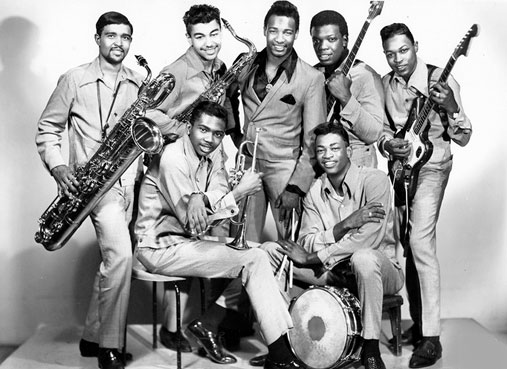
Harvey Scales and the Seven Sounds
- The Exciters
- Gene Williams and the Backsliders
- Jimmy and the Royal Knights
- The Incidents
- Henry Peters and the Imperials
- Show Time, Parts 1 and 2
- Wee Willie and the Exciters
Carole Martin, backed by the Bill Blakkestad Trio, entertained on Sundays.
In a column dated July 31, 1967 (right after the North Side riots), Will Jones remarked:
Despite all the lip service given to integration, and all the laws designed to bring it about, there’s precious little of it in the Twin Cities saloon scene, and in the heart of downtown Minneapolis it’s almost unheard of. That’s why it’s so heartening to see the development at King Solomon’s Mines … The crowds that have been gathering there in recent weeks are as nearly cosmopolitan in their makeup as we’re likely to find in these parts, with a range of ages as well as colors among the clientele. What’s bringing all the people together is a rhythm-and-blues group called The Amazers, who produce a sound to match their name. It’s a beautiful, swinging scene. So beautiful that operator Dean Constantine says his landlords have been making nervous noises about it. This is, however, a small sample of where it’s all at for the future, and should be now. It’s a time for nervous landlords to take a few tranquilizers and allow themselves to be amazed not only by the Amazers but by the amazing young among their following, who already have the whole thing straightened out neatly in their heads.”
The following photos are from an article by Minneapolis Tribune writer Allan Holbert, entitled “Rhythm and Blues is Back – Soul Sounds are Felt, Not Defined.” The band pictured is Gene Williams and the Backsliders, a road band. The article appeared on December 3, 1967, and the photos were taken by Tribune staff photographer Mike Zerby.
From a column from November 1, 1967, by Jim Klobuchar, it may be a good guess that the woman dancing is Chris.

Photo Courtesy Minnesota Historical Society.
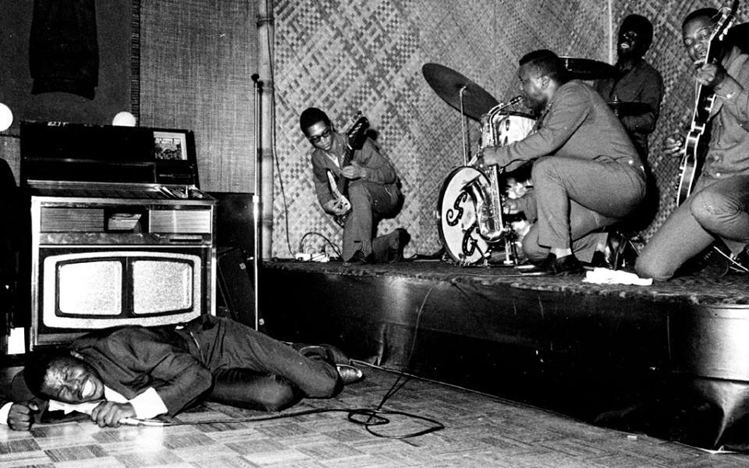
Photo courtesy Minnesota Historical Society
PROBLEMS
On Sunday, October 13, 1968, there was a note in the paper that a new Sunday liquor law was going into effect that day, but that Constantine was planning to continue his Sunday 3.2 beer policy.
On October 16, 1968, something called the Minneapolis Morals and Flying Squad raided King Solomon’s Mines looking for underage drinkers and found 10. One of the girls also had marijuana on her. Constantine said he bent over backwards to screen out the under-21 crowd, and had turned away hundreds and hundreds of kids. The Backsliders were playing that night.
In November 1968 the City Council was debating whether to suspend the club’s liquor license for 60 days, force Constantine to sell the club, or shut it down permanently, the last two as advocated by Alderman Jens Christenson. Although Police license inspector Harvey Everson described it as “the worst run place in the city,” the report in the Minneapolis Star on November 7 seemed to indicate that the only reason for the action was the arrest of the underage drinkers in October; a point was made that the 10 people arrested constituted 5 percent of the customers that night. The decision was made to suspend the liquor license for two months starting on November 11, 1968.
SECRET STASH
In Twin Cities Funk & Soul, Volume 1, Issue 1, September 25, 2012, page 29, there is a fine article about King Solomon’s Mines. Although I do not have permission to reproduce it, I will do so here in the interest of spreading the word about this important Minneapolis venue.
Secret Stash:
In the December 18, 1969 issue of The Minneapolis Spokesman there is an extensive interview with Dean Constantine about the closing of his club … In the short tenure of King Solomon’s Mines, Constantine hired black rhythm-and-blues bands and attracted crowds that were 90 percent black. The real reason he was closed, he figures, was that the white tenants in the Foshay Tower and in surrounding buildings simply did not want blacks in the neighborhood.
Constantine:
The raid that found the minors there was just an excuse. We always had two people checking IDs, and we often turned away 30 or more people a night because we didn’t believe they were 21. We wanted an off-duty policeman to work at the door, but we couldn’t find one who was willing.
Secret Stash:
(Clubs that hire off-duty policemen as bouncers are seldom raided.)
It shouldn’t be glossed over that there were real problems with violence at King
Solomon’s Mines. Dean Constantine recalls more than a few incidents. “Once in a while big Cadillacs would pull up and the trunks would open, then out would come the baseball bats.”
One event in particular that shook Dean happened as they were closing for the night. “A guy pulled a gun on my bartender and the place went silent. My bartender, who was a big guy that looked like Belafonte, started slowing walking toward him. The guy with the gun told him to stop or he would shoot, but he kept walking. When he got to him, the gunman just handed over his gun.” People against King Solomon’s Mines back in the day could say, “When black bands play downtown, black crowds come and there are more problems,” but they would be overlooking something important. King Solomon’s Mines was the only club downtown that catered to the black community. Because It was the only one, all people, upstanding citizens as well as less than upstanding ones alike, came to the club. It’s likely if there had been more clubs like it, each club on its own would have had fewer problems.
When talking with members from local R&B groups from the sixties, King Solomon’s Mines and The Cozy Bar come up far more than any other clubs. Donnell Woodson from the Exciters remembers, “King Solomon’s Mines was a new venue, a crossover for both black and white. Dean Constantine was the door opener.” Another Exciter, Herman Jones states, “The first guy that gave us a break to play in Minneapolis among the white population was Dean Constantine at King Solomon’s Mines. Dean went to the state capital to fight for us – that we should be able to play downtown and in the suburbs. We were one of the few black bands that were playing for white and black audiences.”
Dean himself has become a very revered figure to the musicians and it’s easy to
see why. Ricky Washington says when he was 16 he was playing drums with Billy Holloman at King Solomon’s Mines. He got arrested in a raid and it was Dean Constantine who bailed him out. And Ronnie Scott from the Infinites and Blazers recalls, “Dean Constantine had a thing for the help and the bands. If you did so much business, everybody got bonus checks, which was rare.”
Describing King Solomon’s interior, Anthony Scott from Prophets of Peace
remembers, “They used to have the room set up like you were in Africa. It looked like a jungle, it was real cool.” The club obviously left an impression on Jack Harris from KUXL/Black & Proud Records because once he moved down to Omaha to work at a new radio station, he opened a club with the same name. It even had a picture of a Pharaoh as you entered the door, and mirrors on the walls. Dean Constantine had a career as a dance instructor before running King Solomon’s and continued long after the club shut down. His daughter Deanna continues the dancing tradition.
HIS AND HERS
Constantine threw in the towel and sold the bar to William M. Roslanski and Stuart Z. Schwartz. Bill Roslanski owned the South Barn in Eden Prairie, and Schwartz was a sales manager at KMSP-TV (Channel 9). The transfer of the liquor license was approved by the City Council in January 1969. Constantine became the manager of the Friar’s Club.
Roslanski and Schwartz renamed the bar His and Hers, which opened on February 10, 1969.
Wantads for cocktail waitresses required that applicants be attractive.
In 1969 some of the bands featured were:
- Gregory Dee and the Avanties
- Sages
- Danny’s Reasons
- Del Counts
- Underbeats
- Mystics
- The City Limits
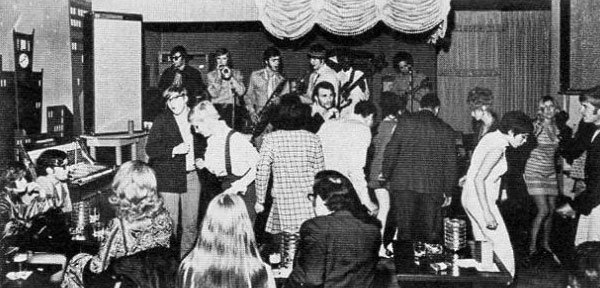
The Mystics at His and Hers, 1969, from the Insider.
By 1969, school dances were cutting into the profits of teen clubs, according to Roslansky. Ads for His and Hers disappeared from the Minneapolis papers in about July 1969. The Insider reported that bands were replaced by a juke box, and Roslansky sold the club to Burt Grossman in September 1969.
THE ESTABLISHMENT
The Establishment was a disco that was opened in late 1969 by Burt Grossman, scion of Grossman Chevrolet. It featured a stainless steel dance floor and had a predominantly black clientele, especially on weekends (Minneapolis Tribune, November 27, 1972). Grossman went on to own the Hippogriff and the Little Prince.
It’s impossible to search for the word “Establishment,” especially if the word is crumbling, but I was lucky to find this:
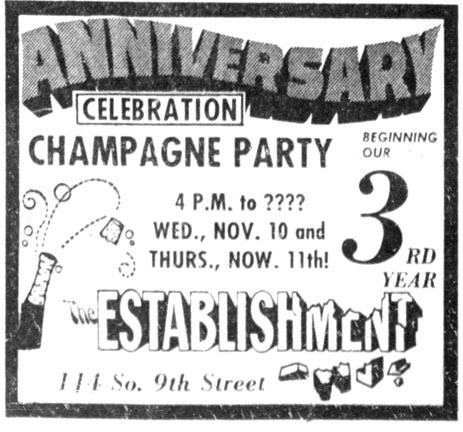
November 10, 1971
I have no idea of a timeframe, but the space was Cork’s by January 1980.
Grossman sold the Establishment in 1977 when he opened the Little Prince Restaurant.
CORK’S
There is evidence of Cork’s from at least January 1980.
PETER’S GRILL
had to move in 1985, and its new address was 114 So. 9th Street, at least until 1990.
CAFE UN DEUX TROIS
was owned by Chef and New York transplant Michael Morse and opened in May 1992. Music and dancing! It closed on April 5, 1993 and declared bankruptcy that November.
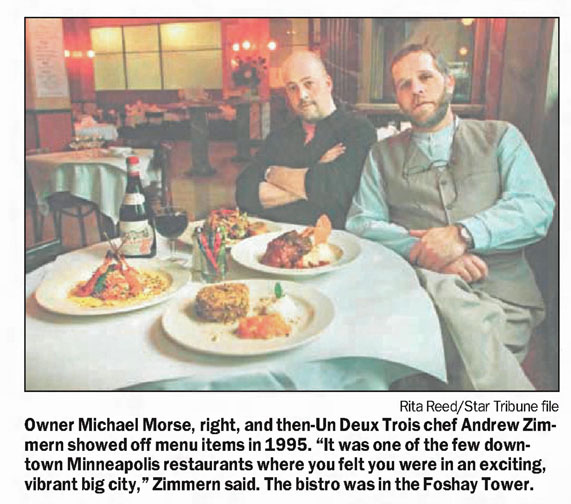
StarTribune, April 8, 2003
RED
was a Russian-themed restaurant that replaced Un Deux Trois in March 2004.
KEYS CAFE
Moved from Nicollet Mall @ 2011.

CSave
The Fox & Hounds was always described in ads as being located at Freeway 35 E at East Larpenteur in St. Paul. Its actual address was 1734 Adolphus Street in Maplewood.
Facebook Fact: Jeff Rhenberg inherited it in his 20s when his dad was in a car accident.
As far as I could tell, the facility opened in 1973. This venue was difficult to research, because the newspaper database did not pick up the unusual font of the club’s ads.
The restaurant/supper club had two levels.
UPSTAIRS
In May 1973 you could get a gourmet meal for two of flaming duck for $15. The main dining room was fine dining – a destination for special occasions. There was also a Judy Pfaff style show every day at happy hour. Judy Pfaff was a popular model who started her own modeling agency, sold it, and became an artist and set designer.
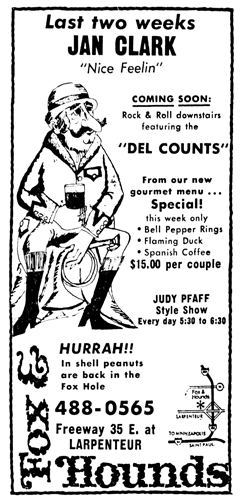
Minneapolis Tribune, May 5, 1973
In early June 1973 there were a few ads for the “Vixen Room” on Friday and Saturday nights.
DOWNSTAIRS
Downstairs there were two venues.
The Fox Hole was a Peanut Bar and dance venue, with rock acts like the Del Counts.
The other venue was a Greek restaurant called Opa’s Taverna, which opened on November 23, 1973 (although ads had been featuring “American and Authentic Greek Cuisine” earlier.) Entertainment was provided by the Athenian Six, “Direct from Chicago.” Bela Stela was the featured belly dancer. Food was prepared by “Presidential Chef” Danny Walker.

Minneapolis Star, November 23, 1973
Opa’s Taverna got generally high marks from Will Jones:
At first I was suspicious of the presence of an electric organ in the direct-from Athens band but I should have known better. Greek saloon music always snaps me into a state of instant euphoria, and this Greek music worked on me like all the rest. When organist Lakis Sakadaris lets his instrument sound like an organ, the effect is hauntingly like Fellini Goes to Athens. Frequently, however, he uses it for a sound like plucked strings, and just riches up the whole maddeningly stimulating bouzouki-and-guitar string sound. The Six Athenians troupe includes George Morenos on bouzouki, Sakis Bravos on guitar, Lakis Vafias on drums, Georgia Kynegos on songs, and Bella Stela on belly. The whole point of Opa’s Taverna is to make you want to yell Opa’a, which means you’re having a good time, and the band part of it works well. (Minneapolis Tribune, December 8, 1973)
These venues may have changed names and uses over the years.
TROUBLE AT THE F&H
The club closed abruptly in 1988 – Charles Schoen of the Del Counts remembers getting a call that the band should remove their instruments post haste before the place was padlocked. Bankruptcy because of unpaid taxes was the problem. Fortunately, the bankruptcy judge saw that the Del Counts were the only thing keeping the club afloat and paid them 100 percent for their entire final two weeks.
The contents of the Fox & Hounds was auctioned off on May 31, 1990.
The building became Champp’s, then the Crooked Pint Ale House, both chains.
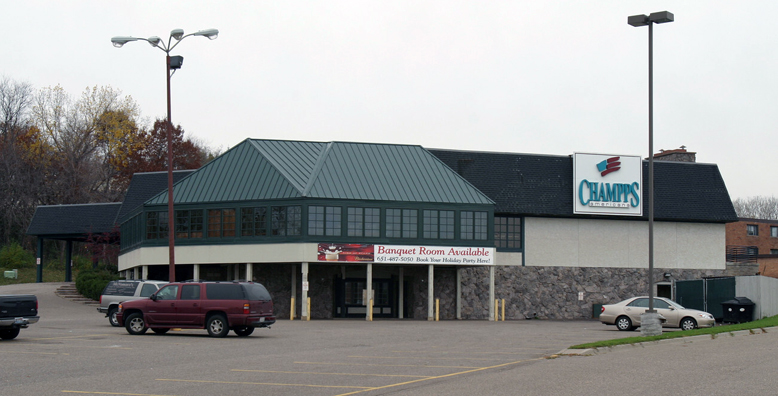
St. Paul. Mystics were house band in 1974.
1066 E. 7th St., St. Paul, 1971
Freddie’s was located at 605 Second Ave. So. (Lewis Building) in Minneapolis. It seems to have had many ups and downs and changes of format.
Freddie’s opened in 1934 and in the ’30s and ’40s it hosted Ella Fitzgerald, George Shearing, and Count Basie.
1948 ad said Freddie’s was for Epicures: “If you are particular about what and where you eat, make it a date at Freddies… where choice foods are prepared and served.”
In 1959 Pete Karalis, who had owned the Cotton Club in St. Louis Park, bought it and brought in big time jazz. A blurb in an article by Cedric Adams on April 13, 1959, says “Freddie’s Cafe [was] rapidly becoming the jazz center of town.” Jazz performers included:
- Ella Fitzgerald
- Gene Krupa
- Ahmad Jamal.
- George Auld
- Dorothy Donegan (April 20, 1959)
- Barbara Carroll (May 4, 1959)
- Carmen Cavarello (July 1959)
On April 13, 1959, Minneapolis Star columnist Cedric Adams mentioned that a new room was being built around the corner at 211 So. Sixth Street. When that opened it would be inaugurated by the Oscar Peterson Trio.
Jack Teagarden did a remote on KSTP radio with Leigh Kamman on May 31, 1960.
In February 1963 Karalis still owned it but it was going broke.
In 1964 Stebbins noted “This night club has since abandoned all musical entertainment.”
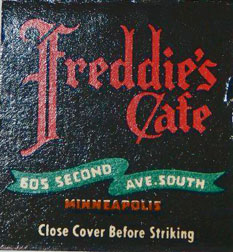
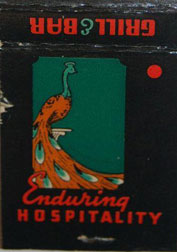
Freddy King’s Tavern was at 501 University Ave. (“On the Avenue” in St. Paul.
A September 1943 ad in the Republican Register says that it offered dancing every evening. Despite being in the Republican Register it claimed to be 100% Union.
downtown St. Paul
Frenchman’s Nite Club was located at 1400 E. 66th Street in Richfield.
This building looks like a tavern, probably because it was probably built to be a tavern: in 1933, in fact, at the end of Prohibition.
An ad in the Republican Register from July 1943 promises Soft Drinks – Dancing – Refreshments.
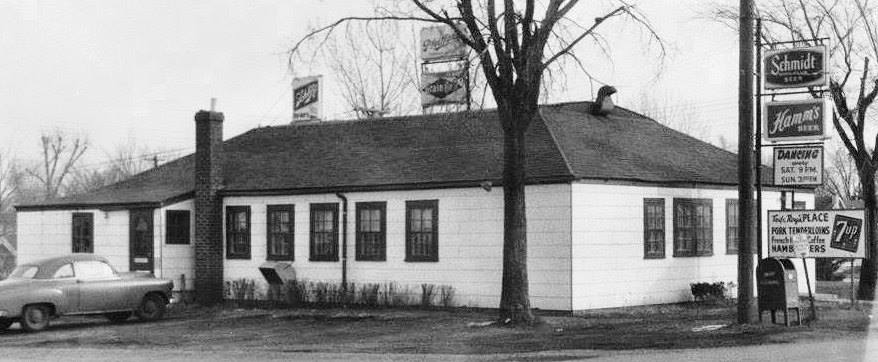
Photo posted by Dale Westdal
The bar has been and is still known as Frenchman’s, although it looks like it says Ted Ryan’s Place in the photo above. Former employees remembered that from 1979 to 1989 it was owned by Bill Snyder, and in 1989 Snyder sold it to Chuck Corday. In 2003 it was purchased by Mary Christine Blake.
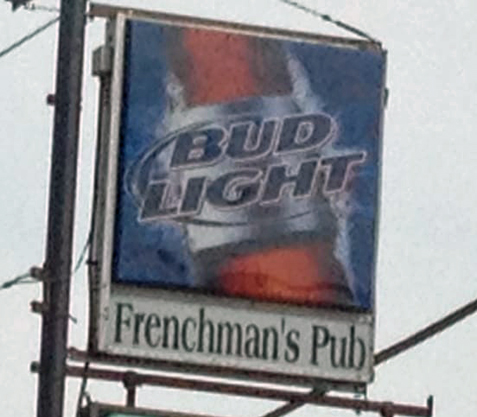
Save
Save
Friendlund’s Cafe and Bar was on Plymouth and Washington Ave. No. in September 1936. It offered foods, wines, choice liquors and entertainment.
Please see Mr. Lucky’s.
516 HENNEPIN AVE.
The Frolics Stage Bar was first at 516 Hennepin. There is an ad for the Frolics in the Republican Register in December 1944 promising Continuous Entertainment from 2 to Closing. Stebbins says that it featured out of town acts. An undated and unsigned memo (probably from the mid 1940s) says that the owner of record was Walter Benz but suspects that Tommy Banks may have held the deed. There was a fire at the Frolics on December 14, 1943, as shown below courtesy of the Minnesota Historical Society.
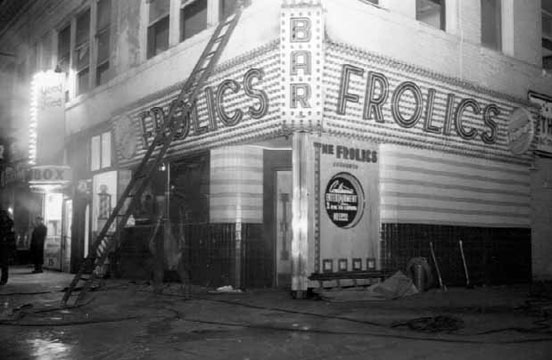
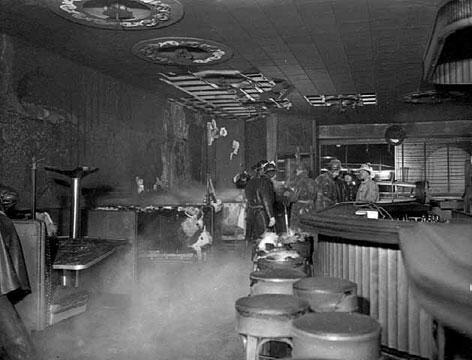
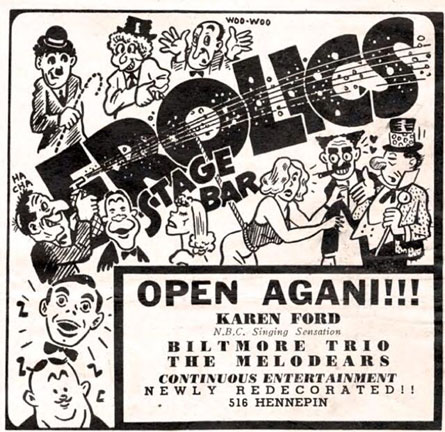
March 1944 ad from Our Town, courtesy Alan Freed
314 HENNEPIN AVE.
In 1957 the Frolics moved to 314 Hennepin and began to feature strip acts accompanied by jazz groups. A 1963 article cited Nick Colich Jr. as the license holder and noted that the bar would be torn down that February as part of the Gateway redevelopment project. Although the Housing Authority bought the building in March 1960, it continued to operate until December 31, 1962. The Frolics was on the police’s list of the city’s six most troublesome night clubs, based on arrest reports covering a five year period, primarily involving morals violations.
The Front Page Restaurant and Lounge was located at 417 So. 6th Street in downtown Minneapolis. It opened in January 1965.
Owners were Victor Levine and Daniel La Barre. (or Daniel LaBarre and Ken Light) and run by LaBarre and Fran Davies of the old Five O’Clock Club.
In June 1966 the bar was bankrupt, but the bar was sold to David Y. Morris, former part owner of the Chalet in Crystal. Morris was Secretary/Treasurer of Teamsters Union Local 320.
October 1966: “Biggest Piano Bar in Town,” featuring Ginny Charland, who could play “Ella to Elvis.”
1969: Jack Seel and Dick Macko.
1970: Entertainment nightly to please all ages.
It burned (down?) in a four-alarm blaze on April 26, 1973. It took 70 firemen and 19 fire rigs to fight the fire, and an adjoining hotel had to be evacuated. Flames more than 100 feet high burst through the roof. Morris owned the building, and the paper reported that he was in the process of selling it.
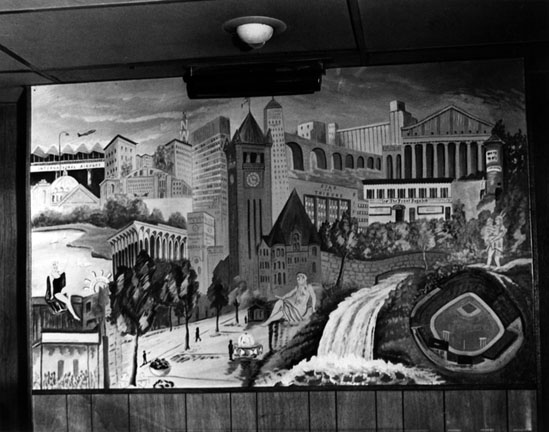
Mural inside Front Page bar, 1970. Photo MHS
The Frontier Club was located at 7365 Old Central Ave NE in Fridley.
Much of the information below comes from an extensive interview with Sherwin Linton, who performed at the Frontier Club quite frequently from 1963 to 1975. I extend my humble appreciation to my friend Sherwin for his information and photos!
Note that I retype the information that is in the ads, because the ads are not searchable.
FRIDLEY NITE CLUB
Before it was the Frontier Club it was known as the Fridley Nite Club, owned by Sheldon Stanley “Shelly” Morris. The first mention of this establishment was on March 3, 1960, in a robbery report. (What would we do without robbery reports?) Morris was an ex-con who did time in three Federal prisons for transporting a stolen car over state lines back in 1946.
Here’s an ad buried in the classifieds:
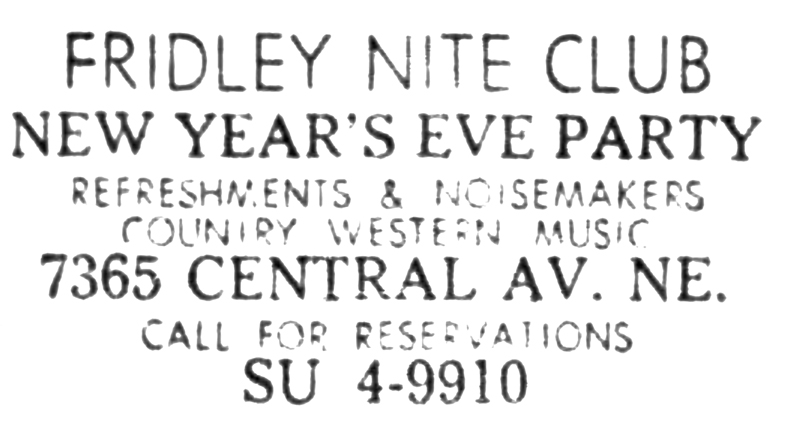
Minneapolis Star, 1960
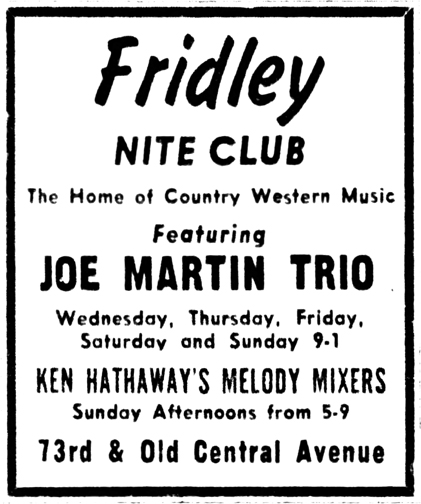
Minneapolis Tribune, December 8, 1961
FRONTIER CLUB
The club must have changed names before December 1962, because a robbery report from that time lists it as the Frontier Club, with Morris as the Manager.
LINK TO THE T. EUGENE THOMPSON MURDER
In April 1963, Morris was indicted for first degree murder in the murder of Mrs. T. Eugene Thompson. He was accused of being an accessory after the fact for handling the luger that Richard Anderson planned to use to kill Mrs. Thompson, and showed police where it was located. He was convicted of the charge, received a five year suspended sentence, and placed on probation. In 1989 he was indicted on tax evasion charges.
NEW OWNERSHIP
In the spring of 1963, Dick and Marlene Povlitzski bought the club from Morris for $3,000. Sherwin Linton indicated that Morris had to sell the club because of his legal problems. Dick had only a third grade education and was illiterate but he could add and subtract and was very good at making money. Marlene had previously owned a 3.2 place called The Mug.
At first the place was kind of a dump, with card tables and in dire need of paint. Sherwin told Dick that he needed to get new tables, which he did, and that if Dick bought the paint, Sherwin and the band would paint the place after they finished their gig, which they did.
SHOWS AT THE FRONTIER
Sherwin and his band, the Fender Benders, were the first band to play there after Dick and Marlene bought the place, in April 1963 until January 1964. Other bands would come and go, but Sherwin Linton’s band would be a staple throughout the life of the club.
A list of performers, culled from the pages of the Minneapolis Star and Tribune and photos from Sherwin, follows.
1963
April to December, 1963: Sherwin Linton and the Fenderbenders
1964
January 1964: Sherwin Linton and the Fenderbenders
March, 1964: The Del-Rays, Johnny Jay
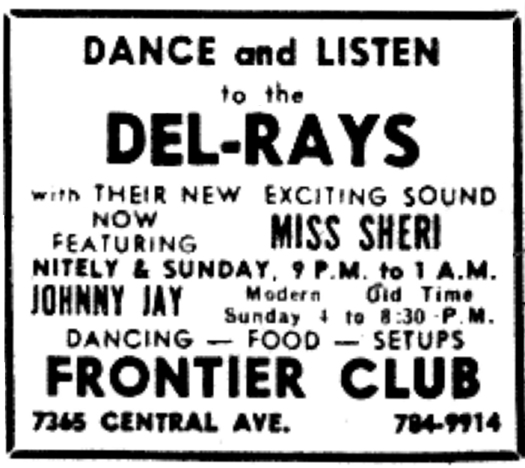
March 10, 1964
April 1964: Sherwin Linton and the Fender Benders
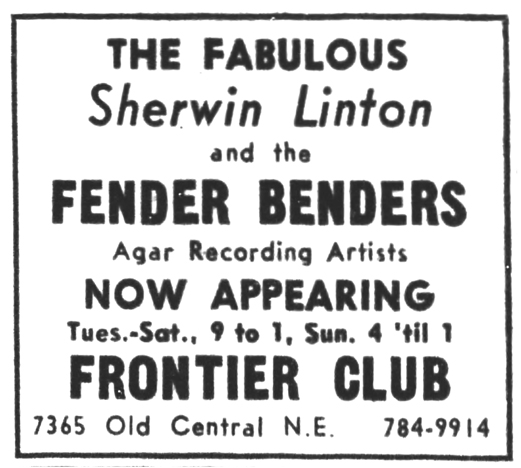
April 23, 1964
1965
In about 1965, there was a a gathering at the Frontier Club of Twin City and Nashville entertainers with the George Kent Band.
Shown kneeling: Texas Bill Strength and Mercury Recording artist George Kent. Standing: Sherwin Linton; Tony Farr; Chill Hilman; Gary Verne, George Kent’s Drummer; George Guinn, who was from Oklahoma and popular in the Midwest; and Wayne Wilson, who later became Buck Owens bass player. All those with matching shirts were George Kent’s band.
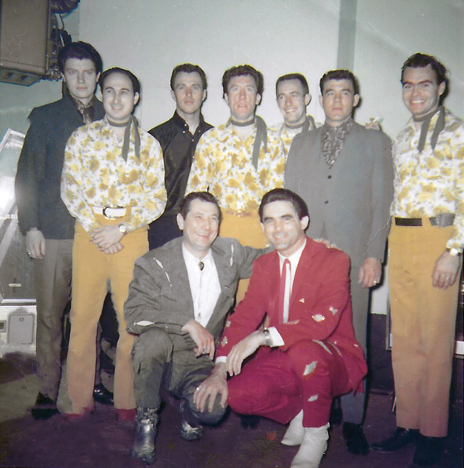
Photo courtesy Sherwin Linton
1966
In 1966, Dick and Sherwin got together and decided to get some “name” entertainment in the club. Sherwin suggested Buddy Knox, best known for the hit “Party Doll.” Buddy took the job for less than he wanted, but he wasn’t working, so he came, and was such a hit that he was held over for an additional two weeks.
Since Sherwin had the connections and knew how to get in touch with the stars, he went to work and got such superstars as Hank Williams, Jr., Ernest Tubb, and Ray Price to appear at the club. This starpower required that Dick dun customers a $3 cover charge. It doesn’t seem like much, but Will Jones remarked that “cover charges have never been popular in the Twin Cities,” even causing popular supper clubs to close. Not so the Frontier Club.
May 11 and 12, 1966: Sheb Wooley
August 12 and 13, 1966: Stonewall Jackson
1968
In February 1968, building on the success of the Buddy Knox show, Sherwin scored a coup and booked Gene Vincent into the club. He was initially booked for one week, but was held over for two more. He showed up in leather pants and a Nehru jacket, and the people loved him!
This was apparently also the time that the Frontier Club expanded, becoming an all-out restaurant.
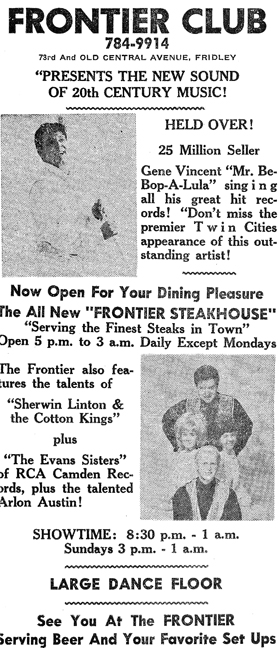
Ad courtesy Sherwin Linton
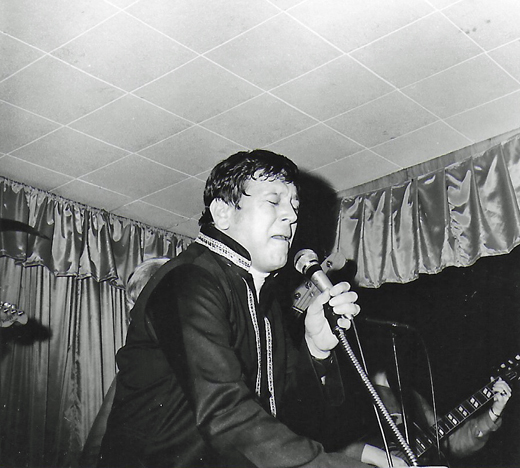
Photo of Gene Vincent courtesy Sherwin Linton
Playing with Gene Vincent below are Sherwin Linton, Ann and Shirley Evans, and Arlon Austin.
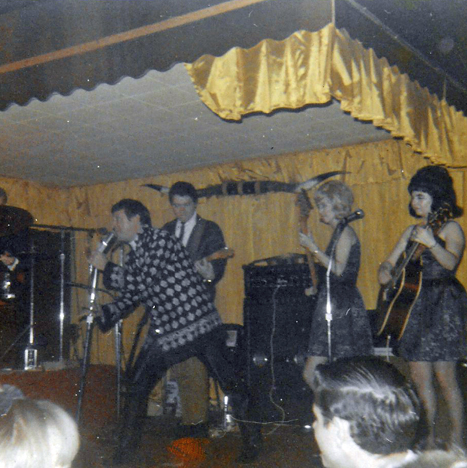
Photo courtesy Sherwin Linton
NO-SHOW JONES
There were other performers, of course, including Merle Haggard, Marvin Rainwater, and Texas Bill Strength. Sherwin told the story of a one-nighter featuring the notorious George Jones. His band showed up by bus, but George was going to fly in. Sherwin had to hurry and drive to the airport, pick up George, and get back to Fridley in time for the set. Of course he got a speeding ticket, and of course “No Show” Jones didn’t show. And without Jones, the Jones Boys wouldn’t play either. The customers, knowing Dick, thought it was all a trick, but it wasn’t. Next time George actually did show up in town, Dick and Marlene slapped him with a summons. Or so the story goes!
1971
August 24 to September 5, 1971: Buddy Knox returned.
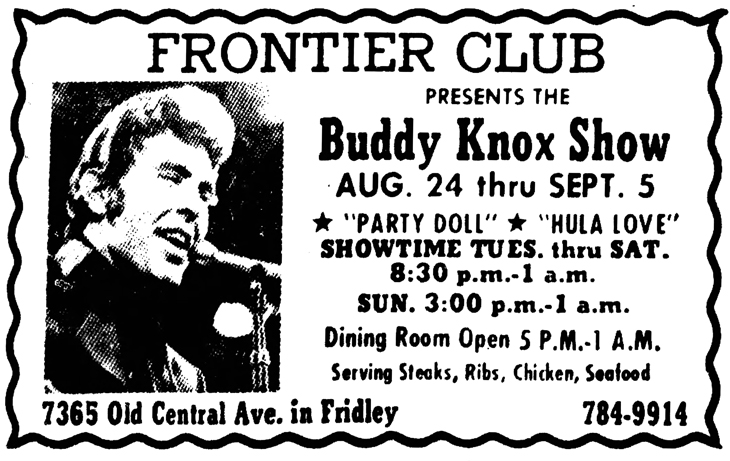
Minneapolis Star, 1971
November 14, 1971: Kitty Wells
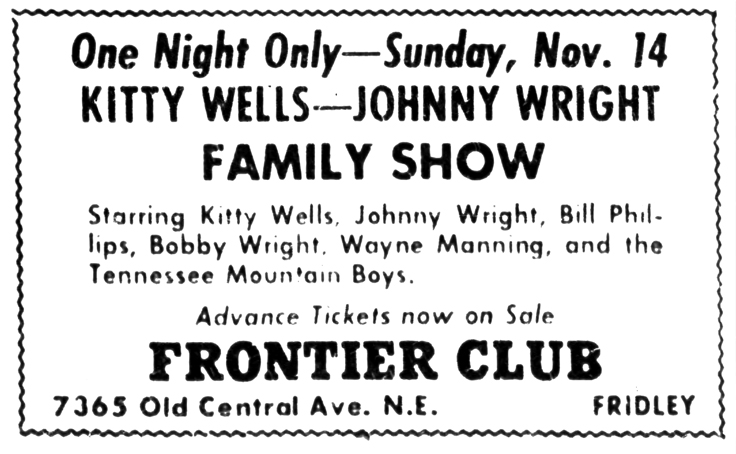
Minneapolis Tribune, 1971
1972
On September 27, 1972, John Richard Snider, 25, was sitting in a booth at the club with club bartender Larry Schmidt, who was days from being 24. Both were from North Minneapolis. They got into an argument, apparently over a salad. Snider went to his car and retrieved a gun that belonged to a friend of his from the glove compartment. Snider returned to the booth, sat down next to Schmidt, pulled the gun out, and fired point blank into Schmidt’s side. Snider immediately said “Call and ambulance” and surrendered to police. (Fridley Sun, October 4, 1972 – rest of the article is missing).
In March 1973, Snider pleaded guilty to second degree manslaughter in Anoka County District Court. He was freed on $10,000 bail pending the results of the investigation. The outcome of this case was not reported in the Minneapolis papers. Thank you to the Fridley Historical Society for this information
1973
April 9 and 10, 1973: Sherwin Linton Show
April 13, 1973: Ferlin Husky – Simon Crum
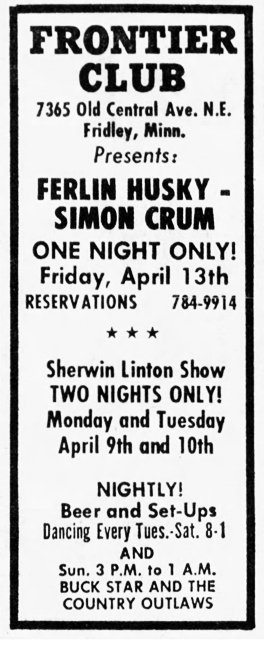
Minneapolis Tribune, 1973
November 11, 1973: Denny and the Tornados
November 20 to December 3, 1973: Sherwin Linton and the Cotton Kings.
Around this time the Frontier Club was broadcast on KTCR radio on Sundays from 3 to 4 pm, and a bit later also on WMIN from 4:30 to 5:30 pm. Bands had little choice but to keep playing, no matter what.
1974
January 22, 1974: Sherwin Linton and the Cotton Kings plus Denny and the Tornadoes
April 12, 1974: Ernest Tubb and His Texas Troubadours
April 13, 1974: Sherwin Linton and the Cotton Kings
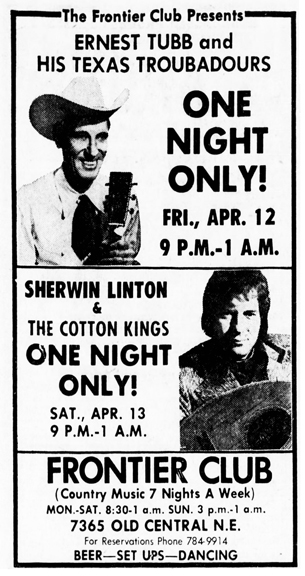
Minneapolis Tribune, 1974
April 19, 1974: Junior Samples
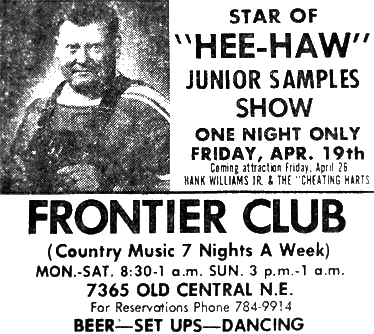
1974
April 26, 1974: Hank Williams, Jr.
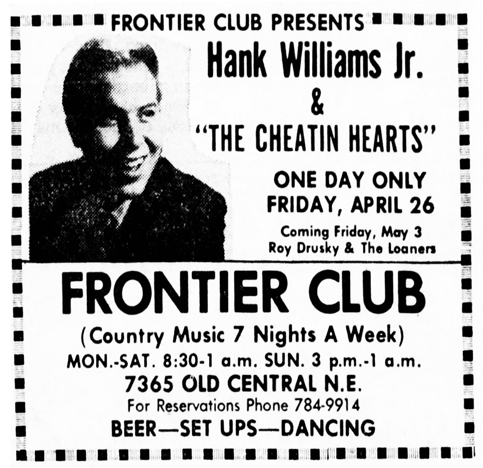
Minneapolis Tribune, 1974
May 1, 1974: Tom Lammon and the Country Souls, nightly
May 3, 1974: Roy Drusky and the Loaners
May 10, 1974: Stonewall Jackson, plus Tom Lammon and the Country Souls
May 17, 1974: Bob Luman and the Stone River Band
May 27 to June 2, 1974: Sherwin Linton and the Cotton Kings
June 3 to 9, 1974: The Doyle Holly Show
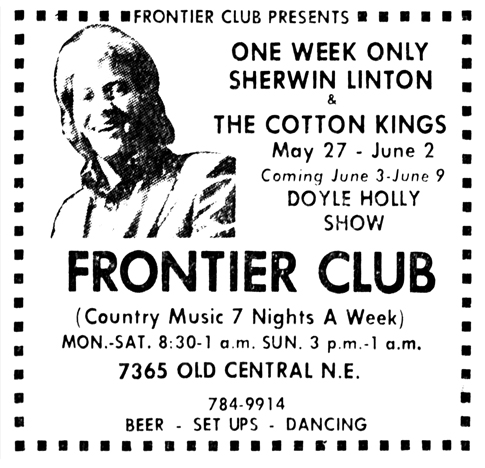
Minneapolis Tribune, 1974
1975
June 27 to 29, 1975: Sherwin Linton and the Cotton Kings plus Cassie Freeman
August 8 to 10, 1975: The Sherwin Linton Show
FIRE DESTROYS THE FRONTIER CLUB
The club was destroyed by fire on November 28, 1975. Keith Zeller reports that his band was there six nights a week, and then one night Dick told them to take their instruments home with them. Lo and behold, the club went up in flames that night, and arson was suspected. Zeller was always grateful for the warning.
The Frontier Club reopened as the Fridley American Legion Post 303 in about January 1977. It sponsored a dance featuring Chill Hilman on April 1, 1977.
Trib columnist Irv Letovsky mentioned this place, a disco that opened in late summer of 1972 on Hennepin Ave. Never heard of it. He also mentioned that on October 13 – 15 they planned to hold a dance marathon, with the winners taking away a wardrobe, a record library, and a weekend at the Playboy Club in Lake Geneva, Wisconsin. Second place gets to stay home, I suppose. A search through the Strib archives brought up Irv’s column and no other mentions, so maybe this club lasted a week?
GALE’S MARKET HOUSE
Debra Deutch Erickson:
In the 1880s, Gale’s Market House offered farm produce at Bridge Square. Located at Hennepin Avenue and 1st Street, Bridge Square was the center of commerce and government in 19th century Minneapolis. Gale’s Market was a popular destination, not only for farm produce but also for the literary and musical entertainment in the hall over the market.
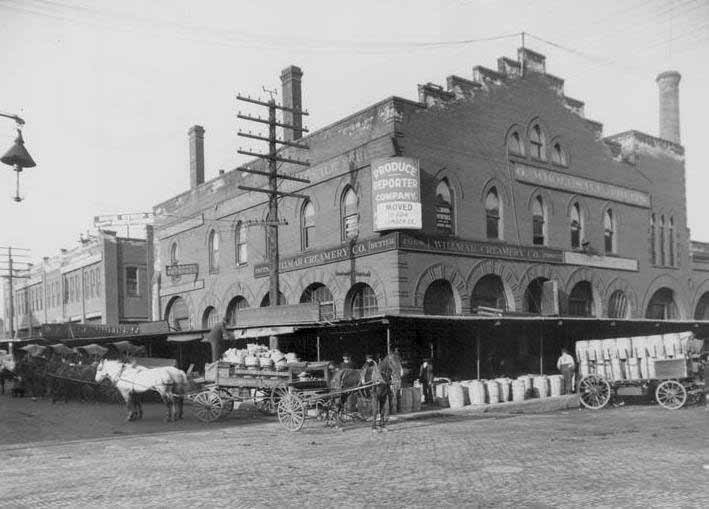
Courtesy Hennepin County Library
Harlow A. Gale was the market master of the building, and the third floor was “crying out to be used” Gale invented the Dime Concert series, presenting entertainment every Saturday night. The concept spread to large cities back east, if you believed the newspapers.
ASSOCIATION HALL In October 1877 the YMCA took over the Market Hall, and “so arranged it that there were two halls, seating 500 and 500 persons, which might be thrown into one large assembly known as Association Hall.” Not exactly sure what that means. Minneapolis Tribune, February 3, 1935.
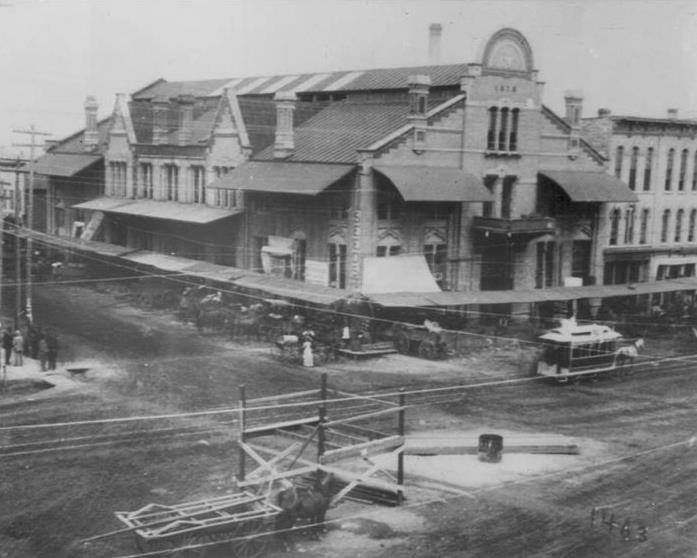
Courtesy Hennepin County Library
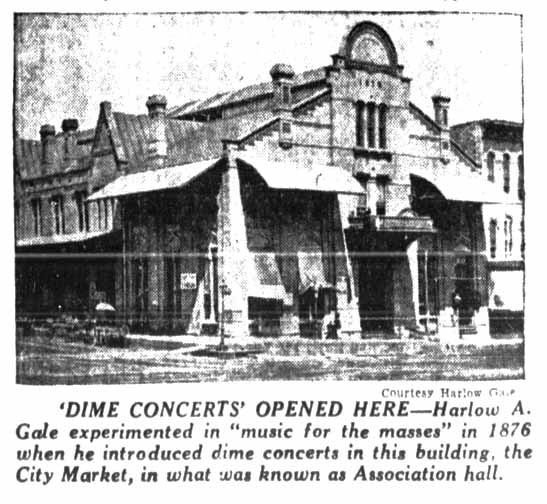
Minneapolis Tribune, February 3, 1935
8th and Hennepin, featured Art Goldberg on piano. He later became known as Hollywood writer Arthur Morton.
Gallivan’s opened in 1933 by Robert “Bob” Gallivan.
The bar and eventual restaurant has had several locations, but always near the Capitol in St. Paul.
SELBY & ST. ALBAN’S
Its first location was presumably at Selby Ave. and St. Alban’s Street, although a street address is not known. The 1933 date makes sense, since that was the year that Prohibition ended.
628 SELBY
In about 1943, the bar moved to 628 Selby at Dale, a block away.
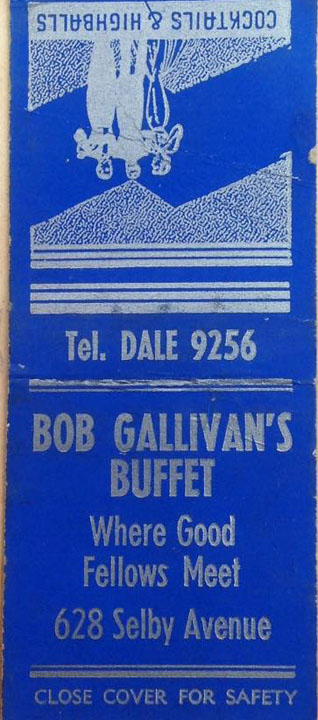
From the collection of Mark Youngblood
372/382 WABASHA AVE. N
In about 1945, the bar moved again. The address was variously given as 372/382 Wabasha Ave. N between 5th and 6th streets.
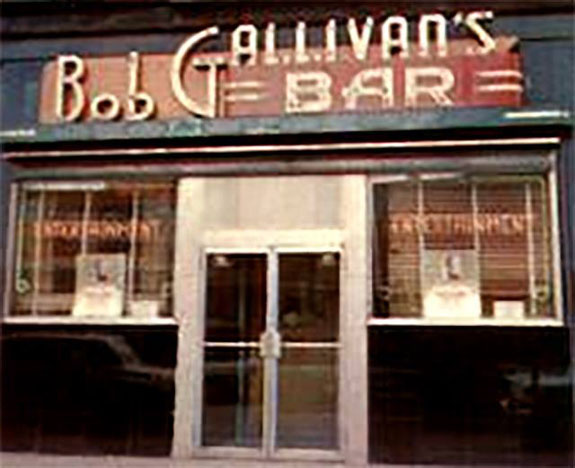
This photo is purportedly of 372 Wabasha
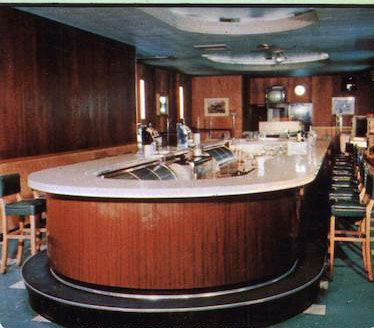
The bar inside Gallivan’s
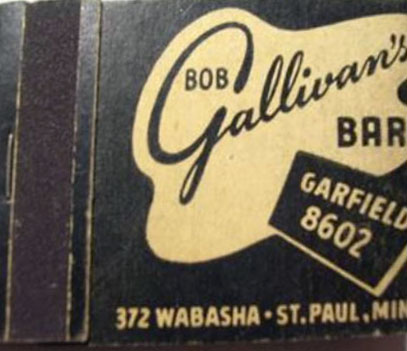

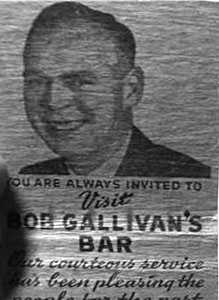
354 WABASHA STREET
In 1965, Gallivan’s was given notice that its location at 382 Wabasha was located within the “Capitol Approach” area – an area very close to the Minnesota State Capitol that had become a slum – and that the buildings were to be removed. (Minneapolis Star, June 2, 1965)
On June 17, 1966, an ad was placed in the Minneapolis Star, attempting to sell off its equipment from the 382 Wabasha by July 1 because it was in the “Capitol Centre Urban Renewal area.”
It appears that 354 Wabasha was the final address for Gallivan’s.
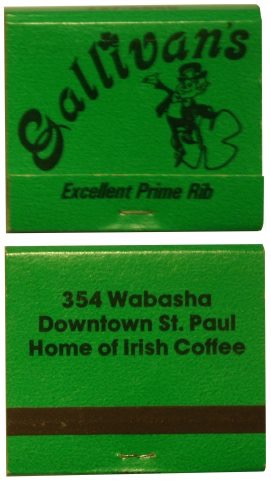
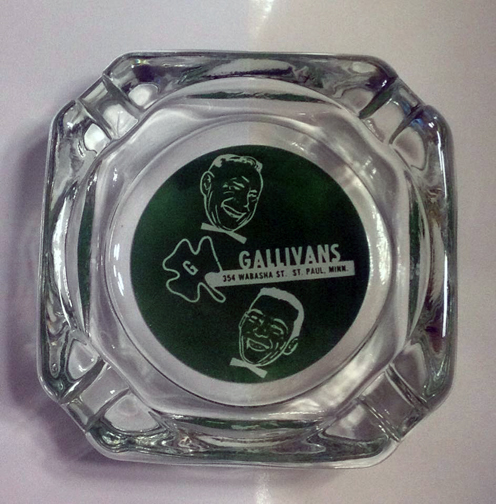
From the collection of Mark Youngblood
In 1967, Gallivan and the regulars brought back the St. Patrick’s Day Parade in St. Paul.
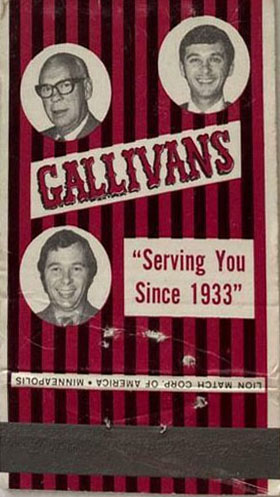
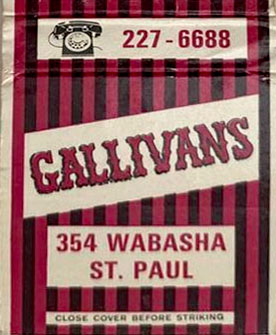
In 1968 Gallivan’s added a restaurant.
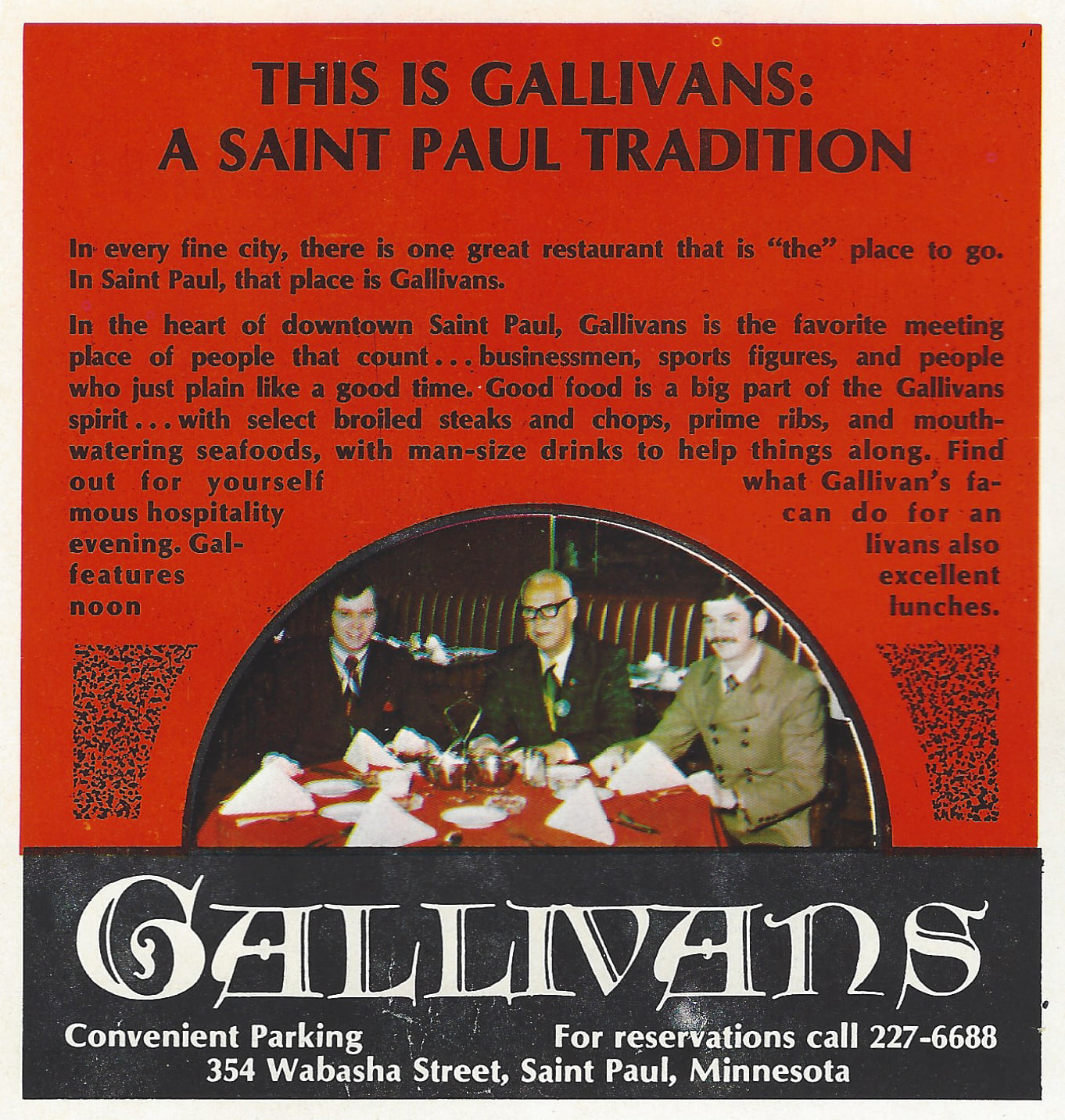
Ad courtesy Tim Gallivan
By at least 1979, Bob Gallivan’s son Pat was the maître d’.
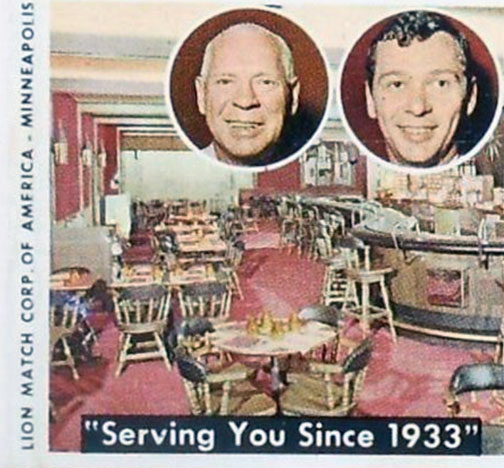
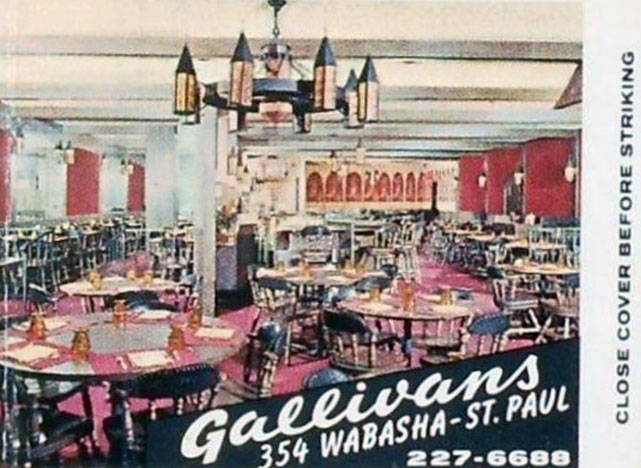
The Gallivan family sold the bar to Jerry and Jean Landreville in 1984, but the name was kept until the Landrevilles sold it in 1988.
Bob Gallivan died in 1993 in St. Paul at the age of 83.
[Tom Gannon’s Cafe, 641 So. Smith Ave. Fire February 15, 1948. Thomas J. Gannon operated Park Recreation, the Parker House in Mendota, and Tom Gannon’s Cafe. Sold Gannon’s October 1955. Died March 1956, age 81]
From there it moved to 2728 W. 7th Blvd. in St. Paul. 1950
In May 1963 Gannon’s had a new piano lounge – Sing along with Mike!
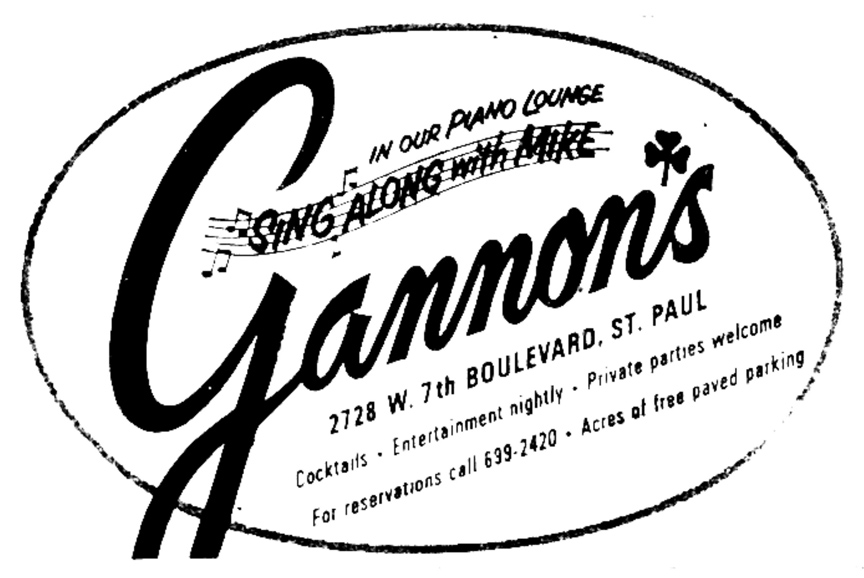
July 1966
Save
The Gargoyle Cafe was a short-lived restaurant located at 719 Nicollet Ave., in the Wilmac Building, in Downtown Minneapolis.
It opened on August 31, 1918. An orchestra was on hand for dancing between 10 and midnight daily.
A big feature seemed to be its ventilation system, promising a complete change of air six times a minute.
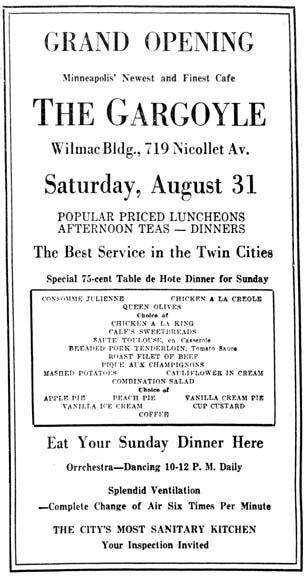
Minneapolis Tribune, 1918
The orchestra figured in a would-be robbery on November 30, 1918, when the patrons never heard the fracas made by young robbers accosting manager William Hersel. Hersel’s valiant fight back, plus the appearance of two soldiers (World War I was on) chased the scoundrels away, but the Minneapolis Tribune’s account gave much credit to the orchestra’s crescendos to make the audience unaware. (December 2, 1918)
Ads for help for the Gargoyle disappeared on August 23, 1919.
The building was demolished in 1969 for the construction of the IDS building.
The Gaslight was at 1420 Washington Ave. So. at Seven Corners, from at least 1960 to 1967.
William Bloedow writes:
Some memories of the Gaslight – from so many. Seven Corners glittered at night. The restaurant was in an old theatre (now the Southern) and only took up a portion of the space. The original stage and arch were in the back, used for storage. The business was owned by the Bonander family, with Lillian always at the door with a cigarette in hand – daughter Gloria and some Leonard with often at her side. Many of my favorite evenings included noted chanteuse Auzie Dial at the piano in the bar. She could do a mean ‘Satin Doll!’ It was a popular spot for the dinner crowd after U of M football games.” An ad from 1967 says that Doc Evans played nightly, and the club had “authentic grand decor typical of the 1890 era.
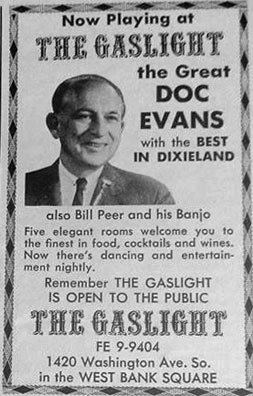
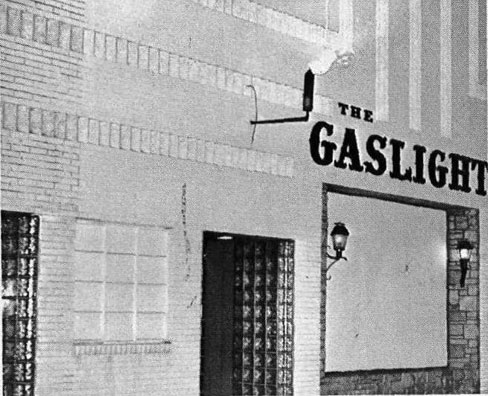
Save
This page traces the most interesting history of the corner of 4th Street North and Hennepin Ave. in Downtown Minneapolis. This corner is difficult to describe, because the block is shaped like diamond if you place it north to south.
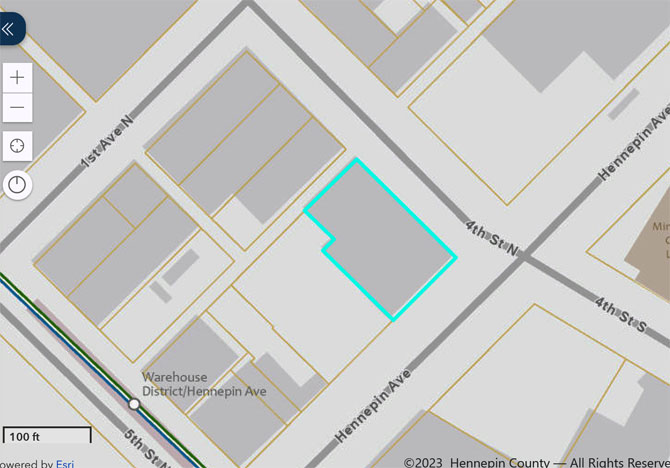
Map from Hennepin County Property Tax Database
The area highlighted in blue on the map above has been the home of some of Minneapolis’s most memorable music (and some non-music) venues. These include:
- The Casablanca Cafe
- The Gay ’90
- The Happy Hour Bar
- The High Life Spa
- The Indian Bar and Cafe/Indian Village
- The Mint
- Palace Restaurant
- The Paradise Cabaret
- Paradise Bar
- The Shanghai House
- Old Heidelberg Cafe
L.M. STEWART
Believe it or not, the corner of 4th and Hennepin, that would become the epicenter of the gay community in Minneapolis, originally belonged to a man named Levi Merrick (nicknamed “the Elder”) Stewart. Like many early settlers of the area, he was born in Maine, on December 10, 1827. Stewart was a Dartmouth-trained lawyer who came to town in 1856. He was a feisty millionaire, who had a proclivity for generating lawsuits and refusing to remove snow from his sidewalks during the winter. He was eccentric, often referring to his wife, while in fact he never married.
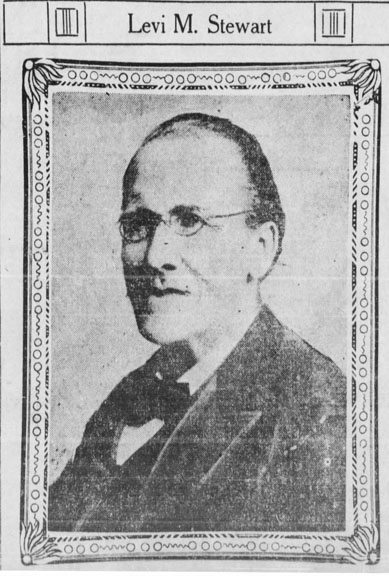
Minneapolis Tribune, May 4, 1910
Stewart homesteaded the corner of 4th Street So. and Hennepin Ave. in 1862 – possibly 1870. He called it “Zion’s Hill” – perhaps a place of refuge. While Minneapolis grew around him, he was offered the equivalent of millions of dollars for his property “an eyesore” to some) for proposals that included a hotel or a hospital, But he was content to live in his little white house with the green shutters, saying that it was just too convenient to his office, which was in the Kasota Building, just across the street (now demolished). (Minneapolis Journal, September 27, 1901)
The caption on the photo below read:
Little white cottage where quaint old man lived and cut the grass regardless of enormous taxes and coming of such overshadowing neighbors as the Kasota Building and the structures of the Northwestern Fire and Marine, Wyman, Partridge, & Co., the Fire Department, and the Salvage Corps.
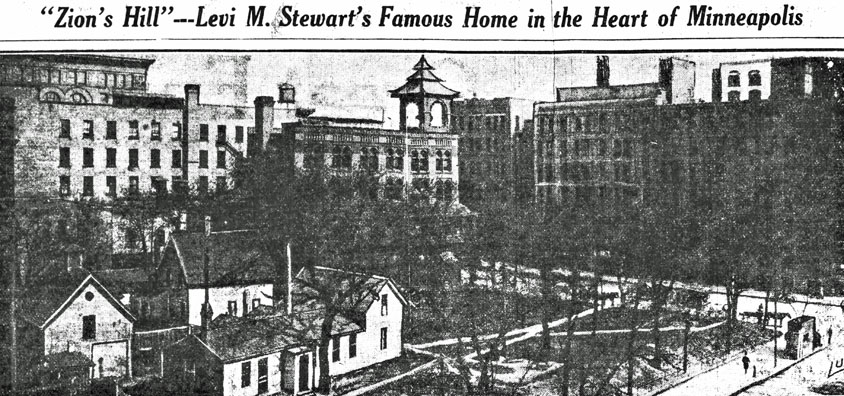
Minneapolis Journal, May 4, 1910
When Stewart died on May 3, 1910, the bulk of his estate went to his younger brother David, who still lived in Maine. (Minneapolis Journal, May 3, 1910) David died soon afterwards, but the land at 4th and Hennepin was eventually sold, as were most of Stewart’s other properties.
THE PALACE THEATER
The first building to go up on Stewart’s “Zion’s Hill” was not a hospital or a hotel, or even a palatial “Stewart Building” that he may have hoped for (Minneapolis Tribune, May 5, 1910), but a 2,700-seat theater. Please see THIS PAGE for information on the Palace Theater. The address of the Palace was generally consistently known as 414 Hennepin Ave. On City inspection cards it was known as 408 – 410 Hennepin Ave.
On the ground floor of the theater there were shops, such as the New Palace Coney Island and Percy Villa’s Sportland. (Percy Villa was a sports writer and a brother to Abe Percansky. Sportland was a pinball arcade.)
In the photo below, the Palace Theater is on the left. The photo must have been taken sometime between 1948 (when the Gay ’90s was established) and July 1953, when the theater was torn down.
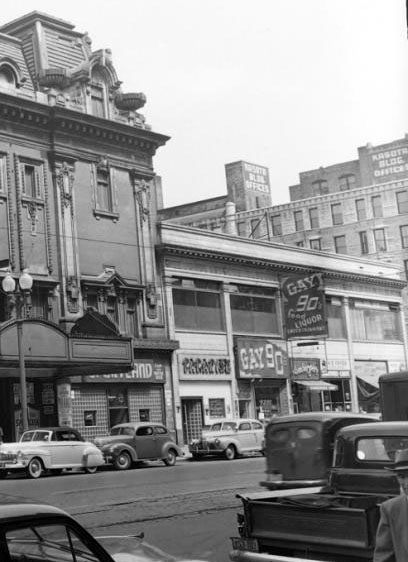
Photo courtesy Minnesota Historical Society
From permit cards it appears that Elder Stewart’s house was finally wrecked in about March 1918.
Records also show a 14 x 16 Pure Oil Station installed at that location in 1920.
1921
THE STEWART BUILDING
No, this isn’t really called the Stewart Building – Levi would be aghast at the thought of people drinking alcohol on Zion’s Hill, and even put it in his will that such a thing never happen, but lessees won the day. Instead of a grand monument to Elder Stewart, the building that appeared on his land was a two-story neo-strip mall, built in 1921, that could accommodate up to six storefronts, with addresses on Hennepin and also on North 4th Street. Pawn shops, bars, steam rooms, bars, mobbed-up joints, and bars were the hallmark of the Stewart Building. (I’m just making that name up, of course…)
Adding to the confusion is that the permit records show the address of the Palace Theater as 408-410, which is actually how the Stewart Building came to be known as.
One might wonder, as I did, why the building I’m calling the Stewart Building, on the corner of 4th and Hennepin, starts with 408 instead of 400. The answer is that the City permit records considered Stewart’s house to be at 400 – 406 Hennepin, which makes better sense.
Making the association of storefronts with addresses more difficult is that businesses have merged, the addresses have changed, and the newspapers have not been consistent when they report addresses.
I will divide the entertainment and some other venues in the Stewart Building into three parts, some of which are based on guesses:
- 408 Hennepin were businesses impossibly jumbled and which become the Gay ’90s since 1948. At the time the picture above was taken, all of the storefronts seemed to be used for separate businesses.
- 410 Hennepin is the storefront closest to the Theater/Parking Lot, and has been the Happy Hour Bar since the 1950s.
- 414 1/2 Hennepin is the basement of the Palace Theater, which hosted a great number of interesting (!) venues before meeting its doom in 1953.
408 HENNEPIN AVE.
What follows is an approximate chronology of three-fourths of the Stewart Building (gotta stop doing that), starting from the corner of 4th Street and running up to 410 Hennepin, where the Happy Hour Bar has been for many years. Because of the problems cited above, there will be overlaps, omissions, and gaps.
1930
WRIGLEY’S
From the folks at Lyfmap we learn that in 1930, 408 Hennepin was one of four Wrigley’s “Famous Good Food Restaurants.” Funny how they had two locations on Hennepin Ave. that were just two blocks apart. In case you get hungry again? This ad obviously came from a program for a downtown show. A newspaper search finds this location extant from July 1922 to August 1932. Wrigley was R.B. Wrigley.
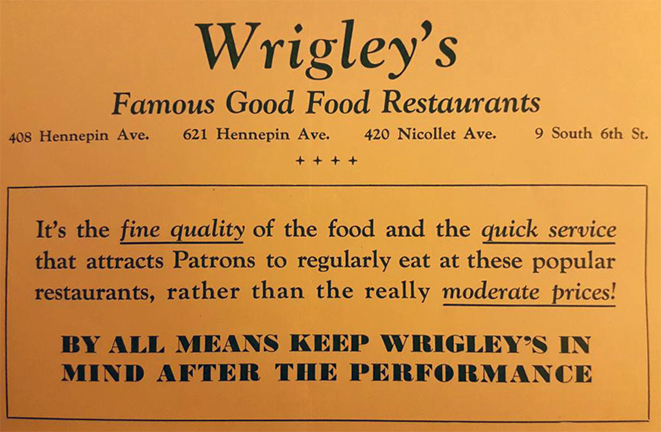
1930 image courtesy Lyfmap
1933
PALACE RESTAURANT
This dining establishment was found opening at 408 Hennepin in March 1933. It followed the Wrigley Restaurant. The last mention found was on November 14, 1933.
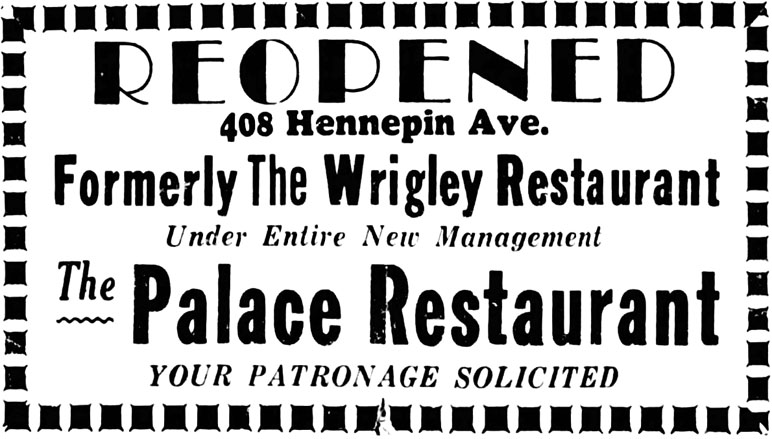
Minneapolis Star, March 14, 1933
1934
STEVEN’S LIQUOR STORE
This liquor store was also given the address 408 Hennepin, starting in March 1934. It was owned by Thomas M. Stevens, who was murdered in September 1934.
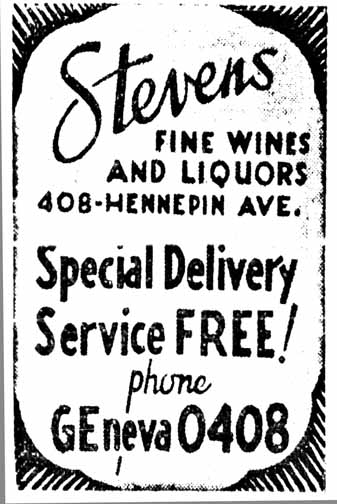
Minneapolis Star, March 21, 1934
1935
HIGH LIFE SPA
Not sure what this was, but the permit card says it was a beer parlor. It was owned by Frank Linehan, and references to it were found from December 1935 to March 1936. It closed in the summer of 1936.
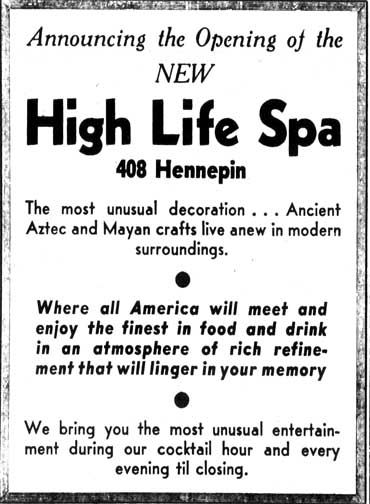
Minneapolis Journal, December 26, 1935
1937
INDIAN BAR AND CAFE
This venue, also listed at 408 Hennepin, was around from February 1937 to March 1938. It was owned by John George Gilbert.
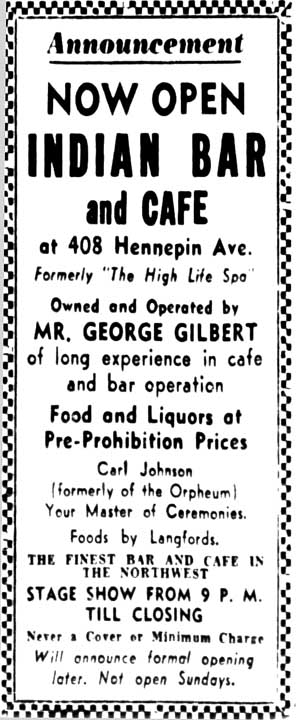
Minneapolis Tribune, February 14, 1937
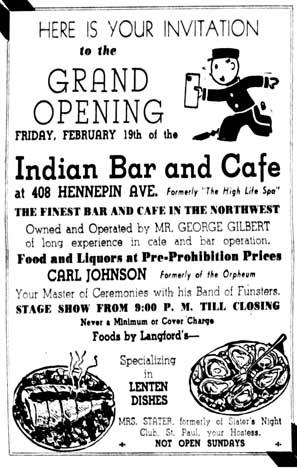
Minneapolis Tribune, February 19, 1937
By the end of 1937 it had become known as the Indian Village.
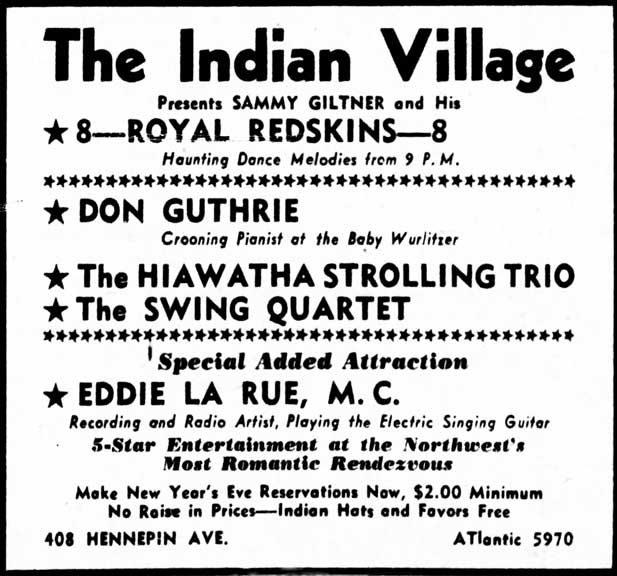
Minneapolis Tribune, December 29, 1937
1943
THE CASABLANCA
The Casablanca Victory Bar and Cafe (Stage-Bar-Dancing) opened at 408 Hennepin on April 5, 1943, in what had been a vacant building for a number of years.
The Casablanca was started by Herman Mitch, who had owned Mitch’s in Mendota. The War had forced him to lease out Mitch’s, and he opened the Casablanca with Matthew Willis. Gangster Tommy Banks loaned Mitch $31,000; $15,000 to start the bar plus money Mitch owed him for bootleg alcohol. Not all of it was repaid.
Mitch brought Red Dougherty from Mitch’s in Mendota with him, and the Casablanca offered Dixieland music to begin. The ad below from December 1943 seems to show that all sorts of music was available at the club.
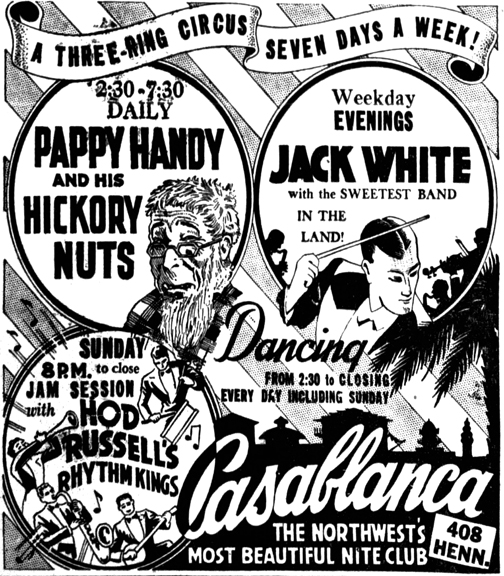
Minneapolis Star, December 2, 1943
1945
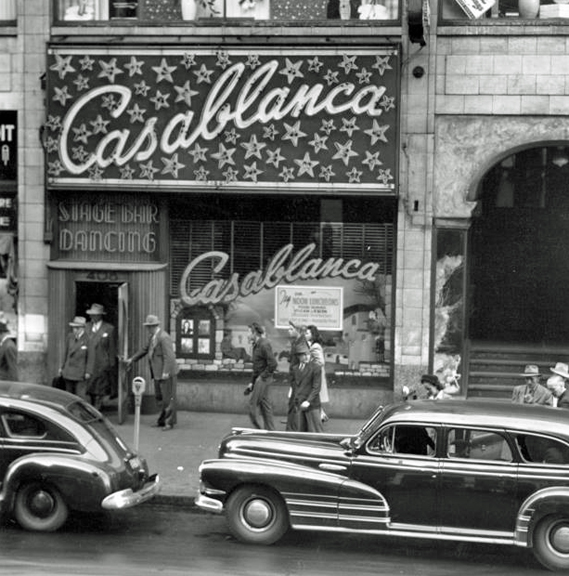
1945 photo courtesy Minnesota Historical Society
MURDER AT THE CASABLANCA
On Friday morning, July 27, 1945, labor leader Albert Schneider, age 37, was killed by four gunshots in a shootout at the Casablanca. Schneider was an organizer for the General Drivers Union 544, AFL. Wayne Saunders (nee Rubin Shetsky), 39, the proprietor of the Casablanca, was charged with second degree murder. Gangster Tommy Banks was at the bar at the time of the shooting and was wanted for questioning. After the shooting Banks fled to his room at the Dyckman and then went “on the lam.”
While he was thinking things through, the local papers told of Tommy’s rise from a bellboy to a powerful underworld figure, “reported to be worth $400,000 to $500,000.” (Another article estimate his wealth as between $500,000 to $1 million.) He was also dubbed “Soft Touch Tommy” for his willingness to help out his friends with significant loans. As to his ownership of night spots, “A member of the liquor industry said Banks owns or has a share in, about 20 cafes or night clubs, or has in the past. They include some of the best known in town. But city and county records fail to show him listed as owner of any of the places.”
After three days, on July 30, 1945, he did come in to answer questions. The Tribune reported:
Banks gave his version of the events that led to the shooting. Saunders, Banks said, had attempted to persuade Schneider to leave the café after the closing hour, but Schneider refused. Banks said he kidded Schneider about his straw hat, then took Schneider’s hat and tossed it away. It landed on the floor and Schneider grabbed Banks’ hat and sailed it back of the bar.
Schneider then demanded that Banks buy him a new hat.
“Why should I?” Banks said he responded.
Saunders then intervened and again attempted to eject Schneider. Banks said Schneider struck Saunders in the side of the head and Saunders fell to the floor. Then shooting began. Banks said in the melee that resulted he was struck in the face and knocked to the floor.
Banks was vague in his statement as to details of the shooting. He said he did not actually see the shots fired. In the excitement he fled to the street with the others and thought the fight was continued outside, he said.
When he returned to sign the typed statement later that night, Banks had his first ever picture taken by a newspaper photographer – in this case, by Ted Miller of the Minneapolis Tribune.
Banks was never implicated in the murder.
Another witness was Fred Snyder, the victim’s brother and fellow union organizer, who named Shetsky as the man who killed his brother after an argument.
Shetsky was indicted on charges of second degree murder by the Hennepin County grand jury on August 1, 1945. He was initially denied bail until his trial, which was set for August 23, 1945. Attorney Archie Cary successfully got him a reversal, and he was let out on bail, which he jumped. It was disclosed in 1952 that four people posted the $20,000 bond:
- Herman Mitch, formerly of Casablanca, Inc.: $5,000
- G. “Mickey” O’Connor: $5,000
- A. Berenson, formerly of Jack’s Restaurant: $5,000
- Tommy Banks: $5,400 (through attorney Cary)
Attorney Cary tried to delay the trial to late September, claiming that he had hay fever at that time of year, but “Judge Carroll disregarded the hay fever plea.” Banks testified at the trial in 1947. Shetsky was first convicted and later acquitted for the shooting.
In 1952, the government said that that the shares were owned as follows:
-
- Banks: 90 shares ($7,800) under the name F.J. Wickers, an employee in his wheel service company.
- Herman Mitch: 34 shares
- Thomas P. Gleason: 56 shares.
Because of the murder, the place was closed from July 21 to August 31, 1945.
On August 3, 1945, William Donnelly deposited $20,000 in cash in the First Produce State bank and received a certified check for the same amount, presumably for the purchase of the Casablanca.
An undated and unsigned memo (probably from the mid 1940s) says that the owner of record was George Benz but suspects that Tommy Banks may have held the deed
When the Casablanca was sold to Toung-Poy (12/1946) and subsequently to A.B. Percansky (9/1948) for $42,500, Banks admitted receiving money.
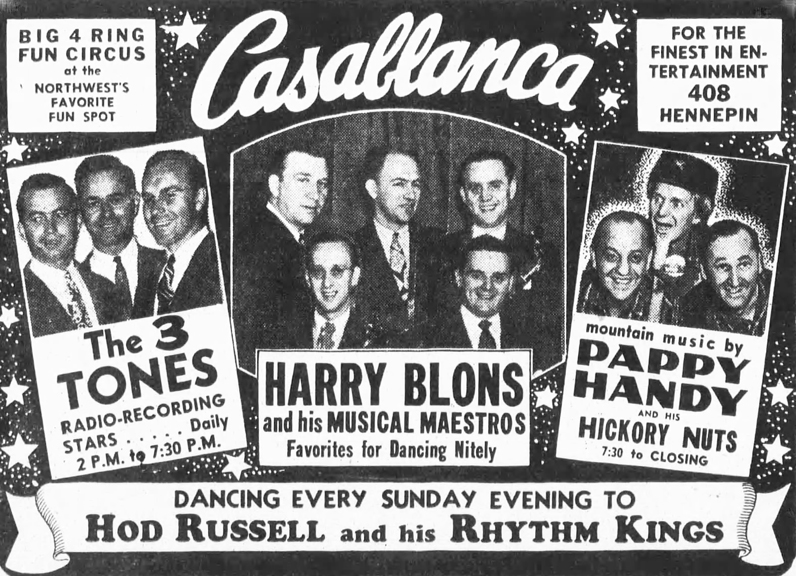
Minneapolis Daily Times, November 19, 1945
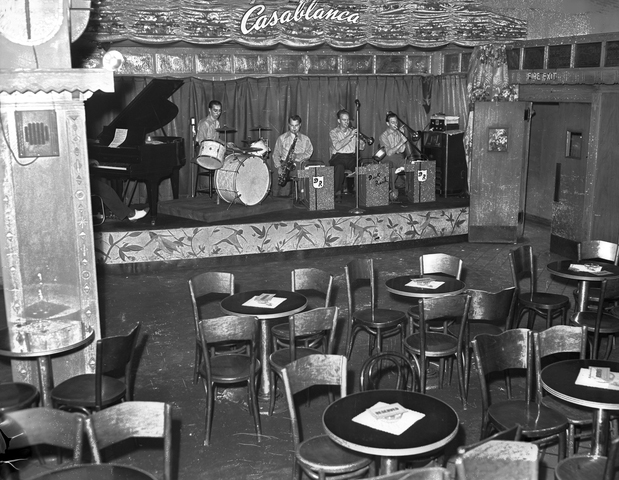
1945 photo of the Dick Rand Band courtesy Minnesota Historical Society
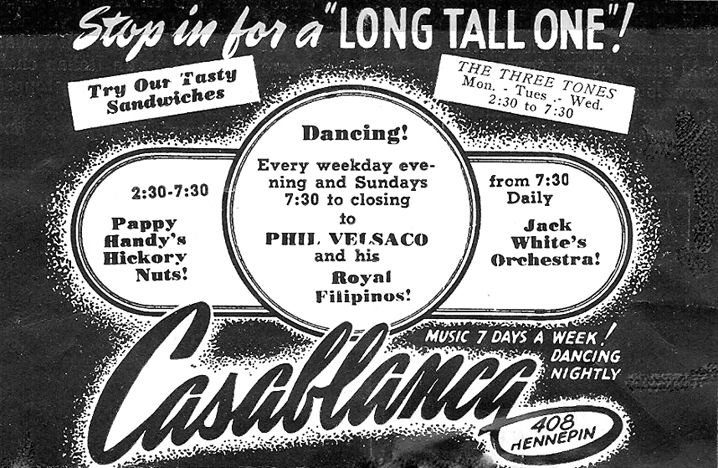
Undated ad courtesy Kathy Gillis
THE SHANGHAI HOUSE
The Shanghai House was advertised at 408 Hennepin from December 1946 to April 1948. It was run by Wang Gin Poy and Wong G. Ping, the same owners of the Paradise, described below. An ad said it was formerly the Casablanca.
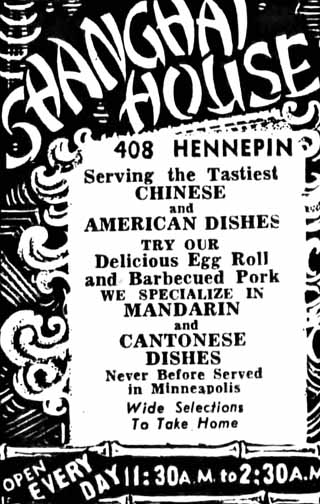
Minneapolis Daily Times, April 17, 1947
1948
THE GAY ’90s
The club was sold to Abe Percansky in about September 1948 for $42,500. The liquor license was in the name of his wife, Mildred Percansky. Local gangster Tommy Banks admitted receiving some money.
It is not to be confused with the Gay Nineties Tavern, on Skid Row.
The club opened on October 27, 1948. At first it was called the Gay ’90s Theater Cafe and Cocktail Lounge. A description said it was patterned after the Gay ’90s cafes in New York and San Francisco. There were 19 murals and 35 smaller panels painted with comedy scenes by Bob Sykes and Henry Haderseck.
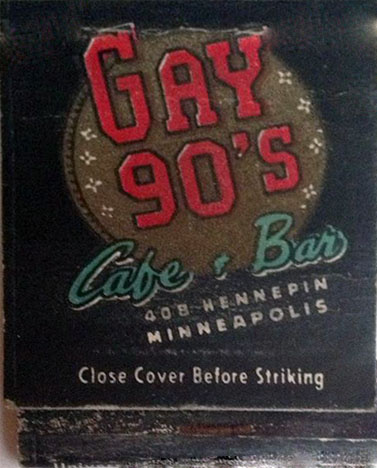
From the collection of Mark Youngblood
The initial policy was to bring in vaudeville acts, starting with the Gay Blades Trio, singer Sophie Parker, and pianist/singer Corrine Dawn. Lenny Colyer was the M.C. Programs would emphasize turn-of-the-century songs, “now in full flush of a revival.” (Minneapolis Star, October 25, 1948)
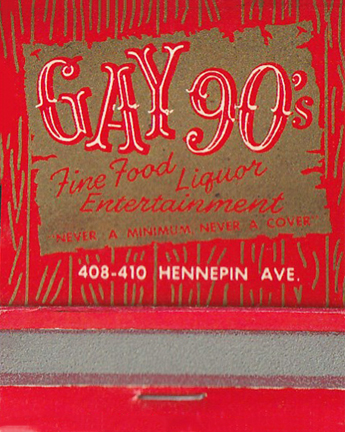
Image courtesy Gordon K. Andersen
In November 1948, the club had a show-stopper of a front window: a huge picture frame, inspired by the art gallery frames of the 1890s when gilt and gold were popular. The picture frame front window, which took months of work, started with drawings of frames at the Minneapolis Institute of Art. A plaster cast of a giant frame was made, and then a wax cast was made of the plaster cast. Aluminum was melted over the wax cast, and then five coats of lacquer were painted over the frame. Painting of the frame took 500 man-hours.
Also in November 1948, it was reported that the oyster bar was one of the most popular features of the club, and the chef was studying old cookbooks for dishes that were popular during the turn of the century. (Minneapolis Star, November 29, 1948)
The placemat below calls the Gay ’90s the “newest and gayest fun spot,” so I’ll put this in late 1948/early 1949.
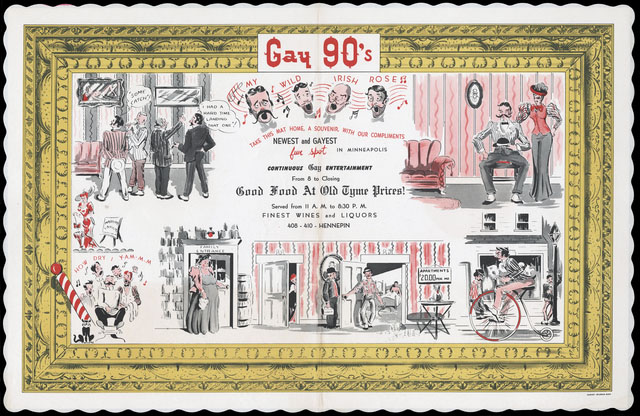
Image courtesy Minnesota Historical Society
1949
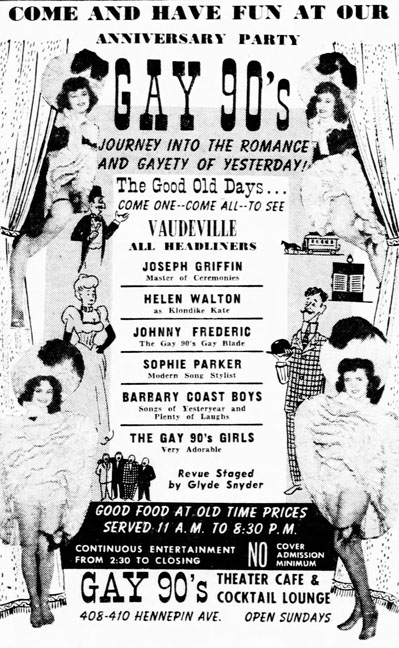
Minneapolis Tribune, November 6, 1949
1950
NOT JUST ANY PLAYER PIANO
In 1950, manager A.B. Perkins (a/k/a Abe Percansky) found an old player piano in the place, and a player piano repairman to fix it. It was quite an intricate instrument; it included a xylophone, bass drum, snare drum, cymbal, and organ pipes. It could also be played as a regular piano. The machine also came with 56 music rolls, each having 12 separate songs, such as “If I Should Love You Sweetheart, Ballad,” “Rose Time in Hawaii,” “In a Tent,” “Love Tales,” and “Bow Wow Blues.” Alas, the old piano began to break down again, and Abe lost the name of the repairman. He wanted to put it on the floor of the club, but it was very heavy, with stained glass on the front. On further inspection, it was found to have been made in Chicago and had a slot for nickels. What Abe eventually did with this white elephant, was not reported.
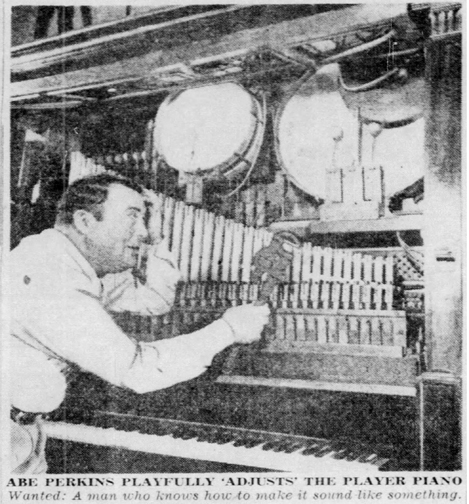
Minneapolis Star, July 18, 1950
The ad below is from a Minnesota Lakers basketball program:
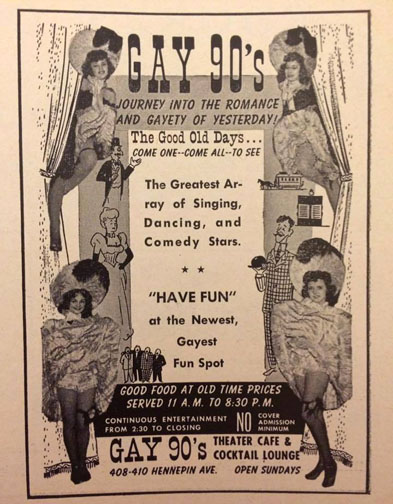
1950 image courtesy Joe Nelson
1951
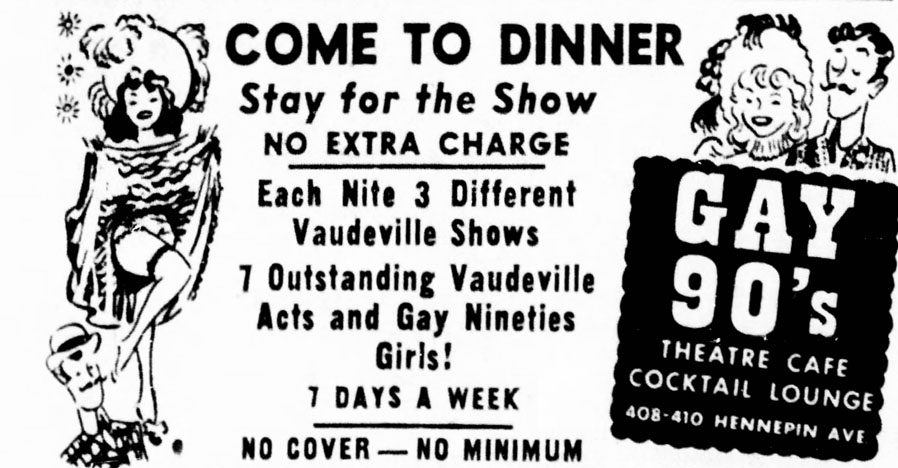
Minneapolis Star, September 7, 1951
1952
In 1952, the club advertised Eddie Bach and His Jentlemen of Jest – see the Magic Bar for pictures of these knuckleheads. Also five Outstanding Vaudeville Acts, and the Gay Nineties Girls! Three shows nightly – Come to Dinner, Stay for the Show!
There’s no date for the menu below, but the wonderful map on the cover shows that the theater is gone, so it’s after 1953. And the Happy Hour is there, so it must be in or before 1957.
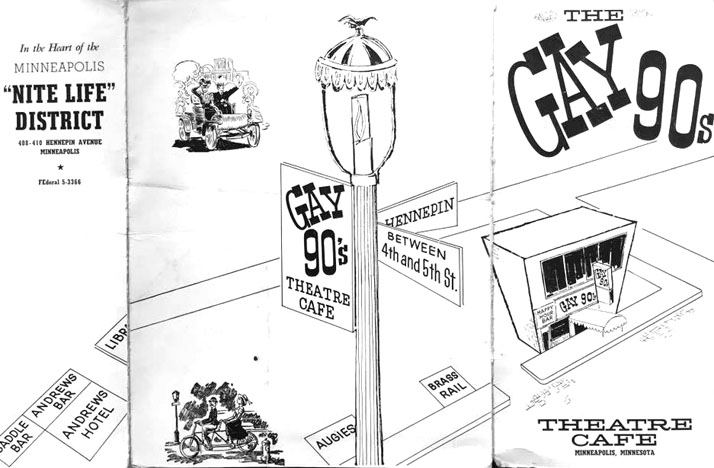
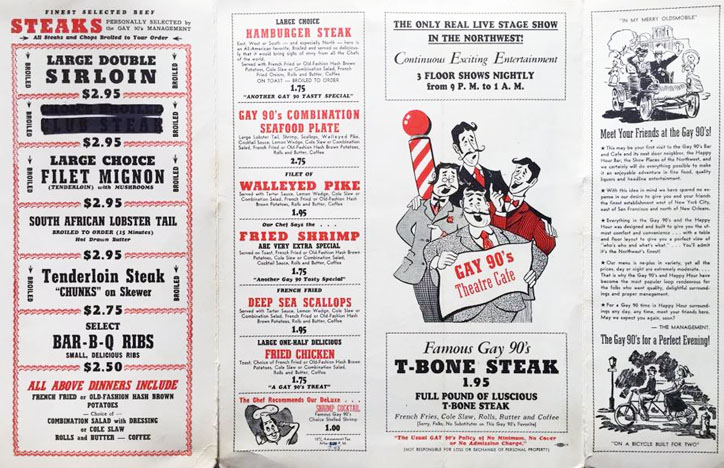
Way back in 1955 there was a traveling show called the Jewel Box Revue. It consisted of men dressed as women, and one woman dressed as a man. In those days the male participants called themselves “female impersonators,” and the Minneapolis Tribune explained that “They dressed in female costumes and affected the mannerisms of women.” The sole woman’s name was Stormy. The troupe had a two-week run at the Gay ’90s, and the Tribune reported that as soon as they were done they promptly left town, as police were ready to file disorderly conduct charges against them. An investigation of the shown was ordered by Municipal Judge Dana Nicholson, who had presided over two female impersonation trials in one week alone. Remember that this was 1955 and there were no gay rights. However, from the ads, the Jewel Box review did return several times to the Gay ’90s.
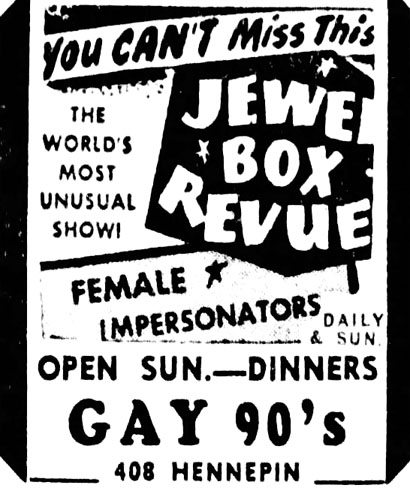
Minneapolis Star, February 2, 1955
1956
COUNTRY MUSIC
In about 1956, the Gay ’90s experimented in Country music, just as the Flame Cafe was changing its policy to all-Country. Will Jones, entertainment columnist for the Minneapolis Tribune, reported on February 2, 1956, that Dave Dudley’s band was playing there every night, and Texas Bill Strength guested on Tuesday, Friday, and Saturday nights. Billboard concurred that Dave Dudley and His Country Caravan had moved in for an indefinite stand, and that Texas Bill was guesting on Tuesday nights. (Billboard, February 11, 1956)
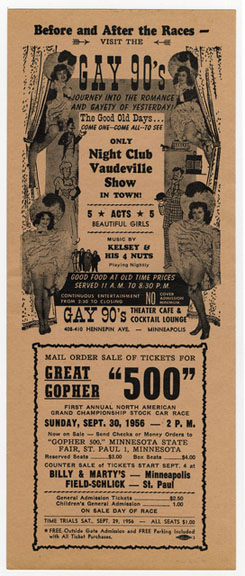
Photo dated September 30, 1956, courtesy Minnesota Historical Society
1957
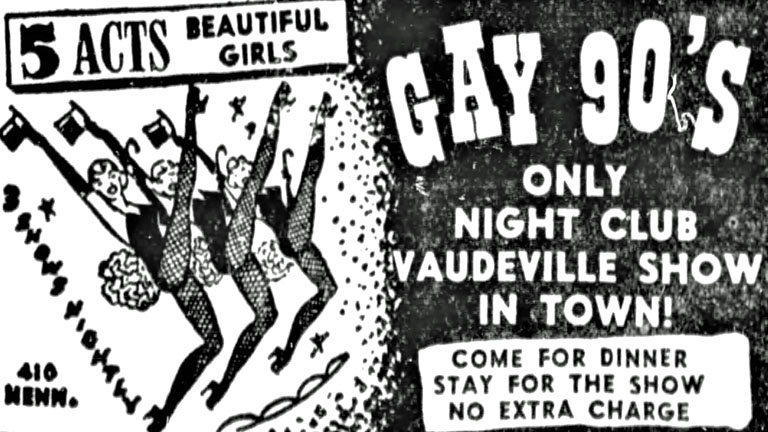
Minneapolis Tribune, Monday, December 30, 1957
1958
From 1958 to at least 1962, Night Beat columnist Vic Burton reported that comic Nate Wexler held court at the Gay ’90s, sandwiched in among several other acts, including other comics. (Minneapolis Daily Herald, July 11, 1962)
1959
In 1959, (Mrs.) Abe Percansky sold the Gay ’90s and the Happy Hour to Ben Rackner, Richard G. Gold, and Alan Robert Cohen, the latter also known as “Big Al.” (Ross Cohen)
In his white slavery trial, Abe Percansky testified that his love for prostitute Marilyn Ann Tollefson inspired him to leave the Gay ’90s, where he was floor manager, and go into business for himself at Alice’s Bar, 500 Hennepin Ave. (Minneapolis Tribune, February 21, 1960)
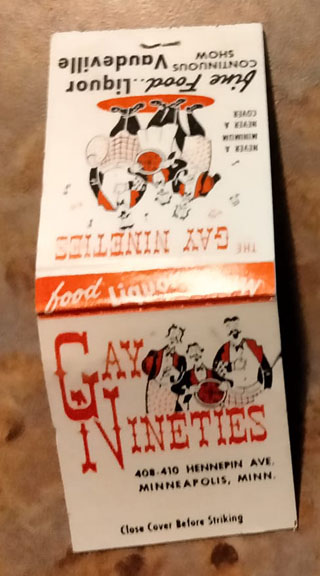
1959 Matchbook – Image courtesy Ross Cohen
1961

Minneapolis Star, December 29, 1961
1962
It appears that 1962 may have been a turning point for the Gay ’90s. “Vodvil” seems to have been replaced by exotic dancers like Rikki Corvette, who was 6 ft. 8 inches tall. She had been performing her exotic dance since the late 1950s.

Mpls. Daily Herald, May 23, 1962
In 1962, the musical entertainment was still all over the place. One ad was for a man in a tuxedo named Art Perry, who was the protege of the late Mario Lanza. He was touted as a star who was on his way UP! (Minneapolis Tribune, October 4, 1962)
The ad below indicates that a show made up of “female impersonators” (in the vernacular of the times) made up the entertainment. At that time, being a homosexual was illegal in the State of Minnesota. See the end of this page for a summary (perhaps out of date) on LBGT law.
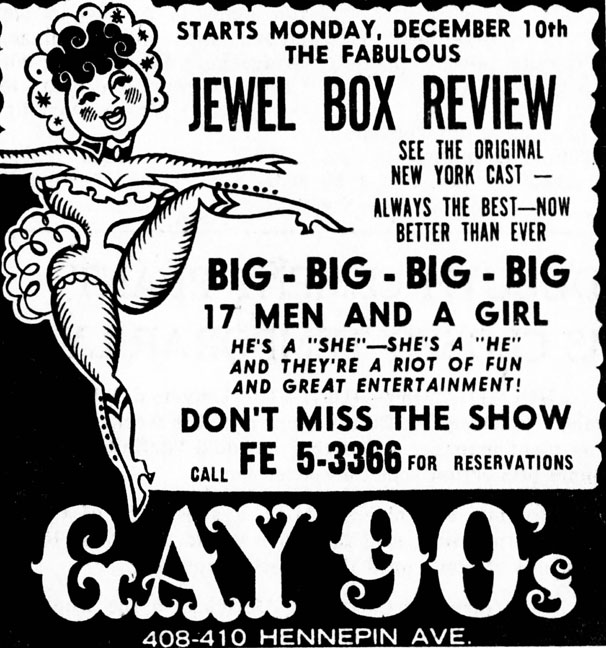
Minneapolis Star, December 3, 1962
At the end of December 1962, police were cracking down on prostitution in the clubs, and commended co-owner Richard Gold, who held the licenses for the Gay ’90s and the Happy Hour, for being most cooperative. Gold had a policy of asking “suspicious-looking” women to leave, while trying not to be accused of discrimination. During a 14 month period, 14 arrests were made. (Minneapolis Star, December 12, 1962) The investigation was dropped.
1964
6 ‘ 8″ stripper Rikki Covette returned to the Gay ’90s in 1964, performing her show after her performance at the Orpheum Theater in “A Funny Thing Happened on the Way to the Forum.”
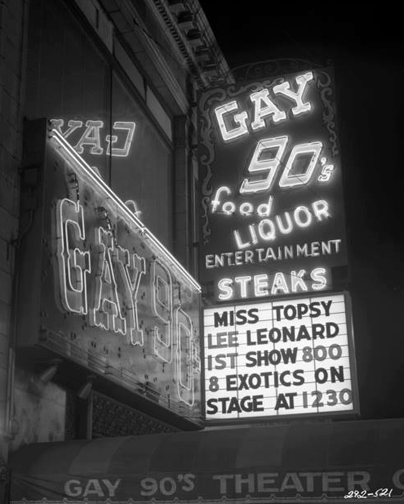
1964 photo courtesy Minnesota Historical Society
1966
Famous 6 ‘ 8″ stripper Rikki Covette returned to the Gay ’90s in 1966, this time to try out her new topless routine before she brought it to Las Vegas. Her memoirs and scrapbooks were eventually donated to the Smithsonian Institution.
1969
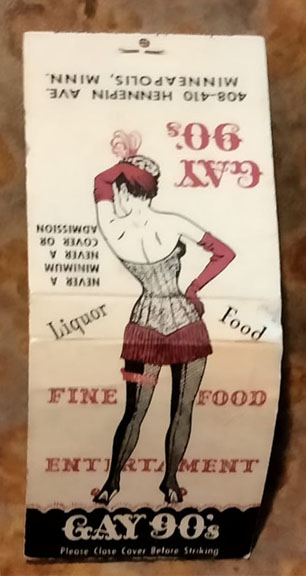
1969 Matchbook – Image courtesy Ross Cohen
1970
Minneapolis didn’t have a Brigitte Bardot, but we had a Babette Bardot….
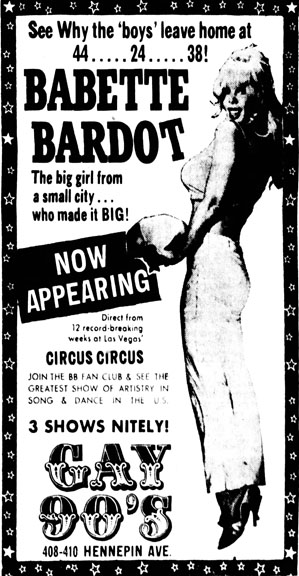
Minneapolis Tribune, December 4, 1970
1972
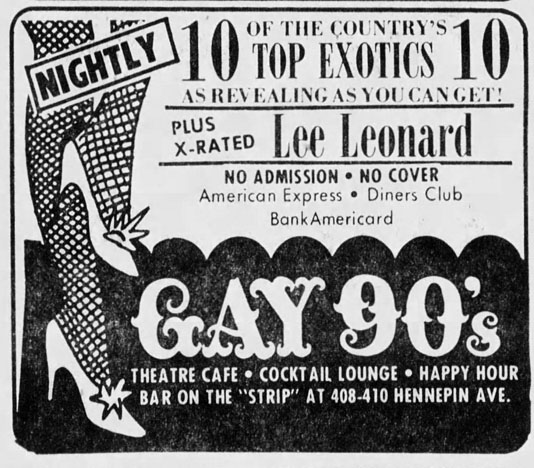
Minneapolis Tribune, March 26, 1972
GOODBYE TO LIVE MUSIC
According to columnist Irv Letovsky, owner Richard Gold dropped the traditional band (in this case the Dave Rooney Trio) for taped music behind the strippers on January 1, 1972. Said Gold:
It works good and everybody’s doing it. You can pick the music you want and the girls can work out their routines the way they want to. Even when we had a three-piece band you couldn’t get much of a sound and you can’t even find three guys who can read music anymore. . . I used to get six or seven girls off the road, but now I’ve got maybe 10 dancers from town and we can train them. They’re younger and cost less and they’re not as hard looking. (Minneapolis Tribune, October 2, 1972)
1975
DISCO DAYS
On August 11, 1975, the Minneapolis Star reported that the Gay ’90s would close as a strip-tease bar as of August 23 and open on September 4, 1975, as a disco.
Richard Gold, owner and manager of the Gay Nineties, said the change to recorded rock music will mark the end of 27 years of strippers and live entertainment at the nightclub. ‘The romance of the stripper is gone,” Gold said. The proliferation of pornographic films and adult book stores has diminished interest in live strip-tease performances. The name and the period atmosphere would be preserved, and would not affect the Happy Hour next door, which attracts primarily gay persons. The new Gay Nineties discotheque, Gold predicted, will be a “jazz discotheque” that would attract “the campy crowd that’s on the street today.” (Minneapolis Star, August 11, 1975)
According to discomusic.com (no longer a viable website), a 12 x 12 foot dance floor was installed at the far end of the dining room, and at 10 pm the disco music began playing.
A show bar upstairs featured female impersonators and drag queens.
1977
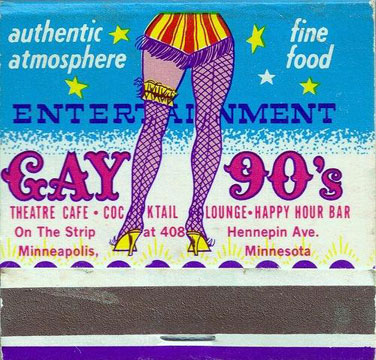
1977 Matchbook
410 HENNEPIN
410 Hennepin is the Storefront in the Stewart Building furthest away from 4th Street. It has hosted the Happy Hour Bar since the mid 1950s. It is part of a building erected in 1921.
Early business found in that spot may include:
- New Way Radio Co. (1922)
- Henry Clay Shoe Store (1924 – 1934)
- Beauty Parlor
PARADISE CABARET
The Paradise Cabaret was advertised as 414 Hennepin Ave. – “next to Palace Theater.”
The first sighting of the Paradise Cabaret was on August 20, 1936, although there is one indication that the Paradise opened its doors in 1935.
It was a place where jazz musicians would play (and gamble) after hours.
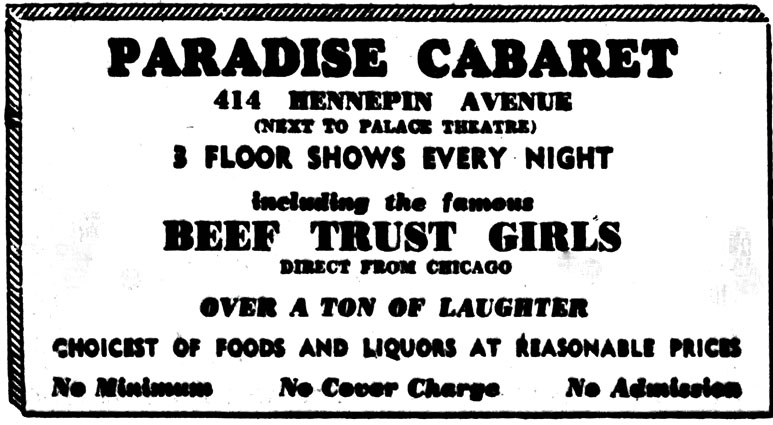
Minneapolis Tribune, September 9, 1936
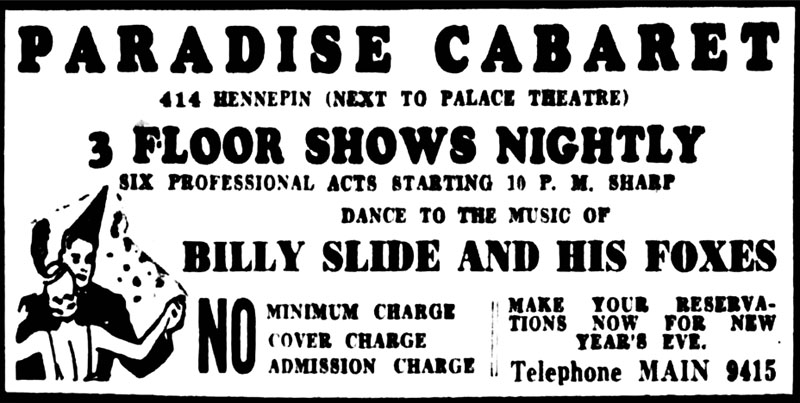
Minneapolis Tribune, Monday, December 21, 1936
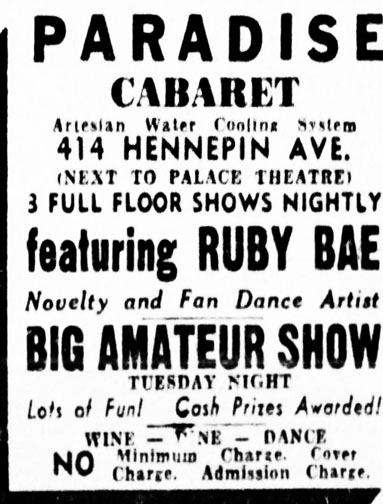
Minneapolis Tribune, Monday, June 21, 1937
In November 1937, the bar was found to be operating without a valid license. The proprietor was Louise Laurentson. As a result, a license was awarded to Al Theis.
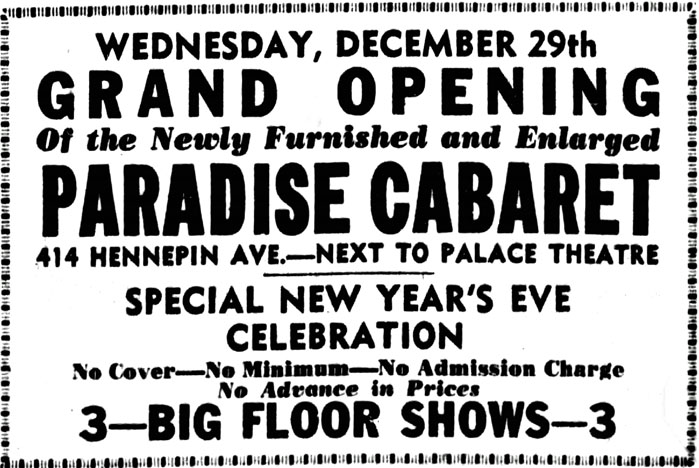
Minneapolis Tribune, Wednesday, December 29, 1937
Your host was Red Stendal in 1938:
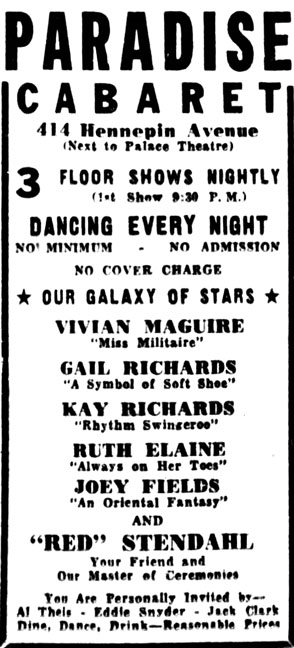
Minneapolis Tribune, Friday, April 1, 1938
But Jack LaBelle invited us on April 29, 1938:
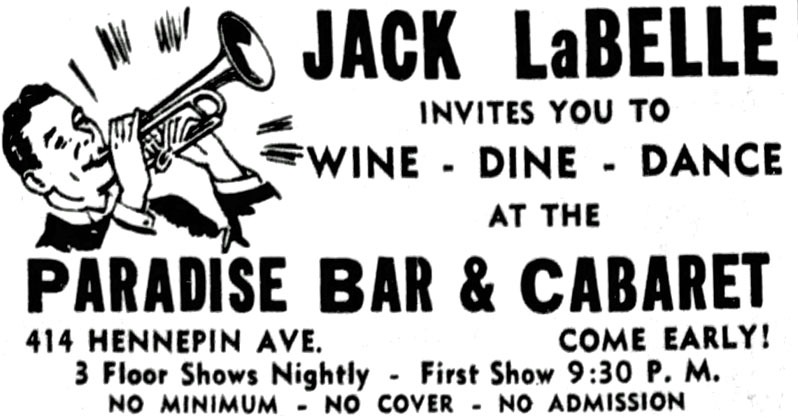
Minneapolis Tribune, April 29, 1938
And Jack La Belle and Eddie Snyder invited us on June 10, 1938.
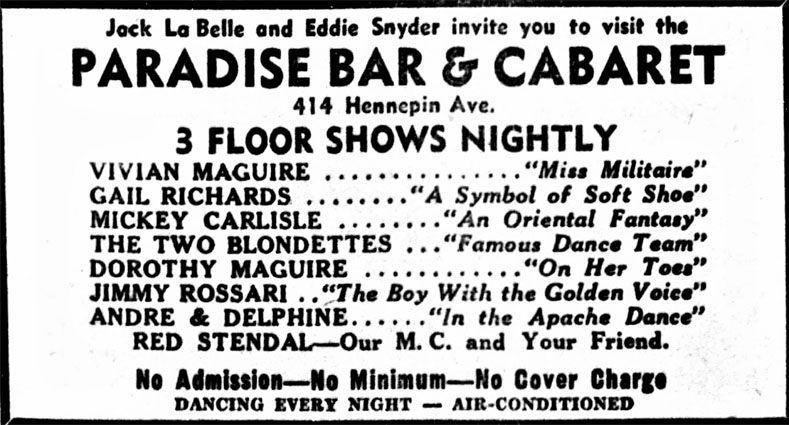
Minneapolis Tribune, Friday, June 10, 1938
Red Stendal was back as the M.C. on September 7, 1938.
TROUBLE IN PARADISE
The Paradise Cafe (as it came to be known) met with disaster when it was raided on Sunday, March 12, 1939. Your genial host, Red Stendal, and waitress Helen Dillon were caught serving a highball to a member of the police morals squad at 11:30 pm that Sunday. About 40 patrons were in the place at the time, police said. (Minneapolis Star, March 13, 1939) Al Palmersten, head of the morals squad, said there had been complaints about the place. Red and Helen were arrested and their bail was set at $200 each. (Minneapolis Tribune, March 13, 1939)
The two were arraigned in municipal court on Monday, March 13, 1939, and their trials were set for Friday, March 17. The case was continued until March 29 because Alderman E.A. Hendricks, attorney for the cafe, was on his way to Washington, DC for official business.
On March 30, Red and Helen were convicted of liquor sales violations in municipal court, and sentenced to fines of $100 or 90 days in the workhouse. The sentences were stayed until April 10 to allow time to appeal. Helen was found guilty of selling liquor before the opening hours on March 14, and Red was guilty of selling liquor on Sunday. The judge, Paul Guilford, said,
In these cases, sales were clearly made in an open and notorious way. For this reason I believe licenses of the place should be revoked. (Minneapolis Star, March 30, 1939)
The man who held the licenses for the establishment was Alvin N. Theis, and he and his lawyer fought to keep his licenses despite the actions of his manager and waitress. However, on March 31, 1931, the City Council voted to revoke all licenses attached to the Paradise, and the police came to the club and picked up the licenses. These included his liquor, beer, restaurant, soft drink, cigarette, dance hall and tavern licenses. The Paradise was closed on Friday, March 31, 1939. (Minneapolis Star and Minneapolis Journal, March 31, 1939) On April 8, 1939, Theis was fined $50 for selling liquor after hours.
Coda: Gordon E. Greene, manager of the Palace Theater, applied for a new license for the Paradise Cafe’s spot, but was turned down because there had been 11 convictions growing out of trouble in the Paradise since 1935. (Minneapolis Tribune, April 11, 1939)
The revoked on-sale liquor license for the Paradise Cabaret was transferred to a new location at 401 Plymouth Ave.
The photos below, taken sometime between 1948 and 1953, shows the Paradise taking its place between the Theater and the Gay ’90s.
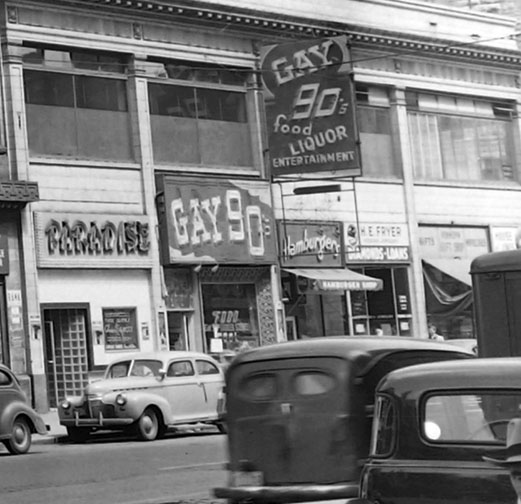
Photo courtesy Minnesota Historical Society
THE HAPPY HOUR
Don’t confuse this with another Happy Hour on Nicollet Ave., which was built in 1938 – that club burned down in November 1947, and when it was rebuilt it was renamed Club Carnival and then the Famous Flame Cafe.
This club was next to the Gay ’90s and was often referred to as an annex to the larger club. The two clubs operated on the same liquor license. For at least the first ten years, from the mid 1950s, it was owned by Abe Percansky.
The bar became a gay hangout in about 1955, according to one article. (The year 1957 is on the building in tile.)
1962
In 1962 the Happy Hour was owned by Richard G. Gold. He almost lost his licenses over charges of prostitution, but he cooperated with the police in kicking known prostitutes out of the bars (Gay ’90s and the Happy Hour), so the investigation was dropped. (Minneapolis Star, February 20, 1963)
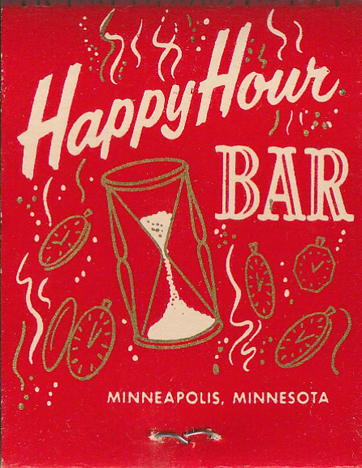
Matchbook image courtesy Gordon K. Andersen
In 1975, owner Richard Gold said “The Happy Hour attracts primarily gay persons.” (Minneapolis Star, August 11, 1975) On September 4, 1975, the Gay ’90s, which Gold also owned, became a disco, and at that time, doorways between the two bars were opened, according to discomusic.com.
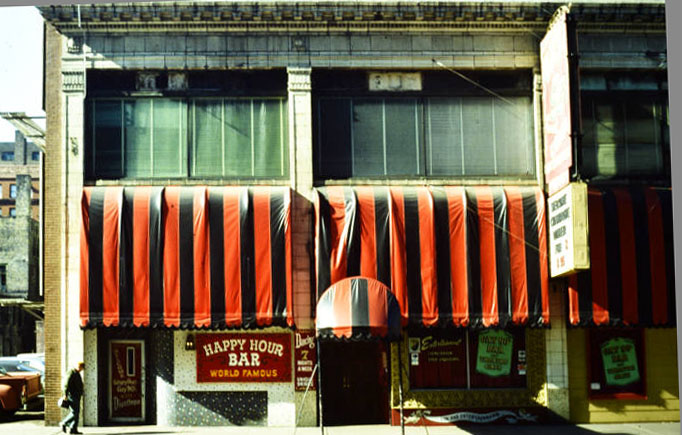
1978 Image courtesy Hennepin County Library
414 1/2 HENNEPIN AVE.
414 1/2 Hennepin Ave., I’ve come to realize, must be the address for the basement of the Palace Theater. The businesses may not have given themselves that identification, but that’s my guess.
I’ve made the following list in chronological order, taking hints from the ads themselves when they say “formerly the,” and so on. Please feel free to contact me with better information.
STARKEY
From at least 1915, which is about when the theater was built, the space was used as a deli, lunch counter, or cafe. The name William Starkey predominates until 1924.
SOUTHERN CHICKEN TAVERN
But then out of nowhere, in March 1921, there is an ad for the Southern Chicken Tavern. “Chicken Shacks” were prevalent among saloons that were suddenly put out of business by Prohibition in January 1920, but it’s a mystery as to why this only advertised briefly. It is also labeled 414 1/2, and “next to” the theater.
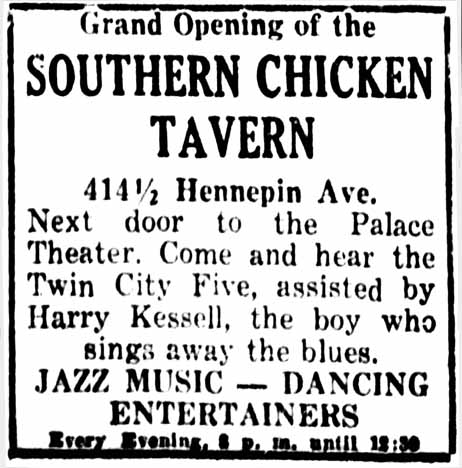
Minneapolis Tribune, March 20, 1921
SCHUSTER
In November 1925, we find Schmidt & Schuster joining forces in their downstairs Rathskeller.
After that, it appears to be Schuster’s business from then on. Below is an ad for Schuster’s Cafe in August 1930. Even when the entrance is pointed out, it’s not 100 Percent clear where the restaurant is, but my guess is that that’s the door to the basement.
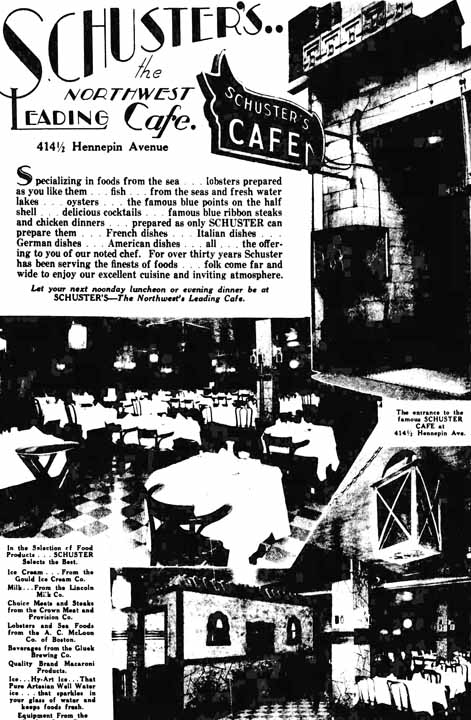
Minneapolis Tribune, August 30, 1930
OLD HEIDELBERG
In September 1933, 414 1/2 became the Old Heidelberg Cabaret and Nite Club, heavily advertised in the Saturday Press newspaper. One ad says that it’s in the Palace Theater building.
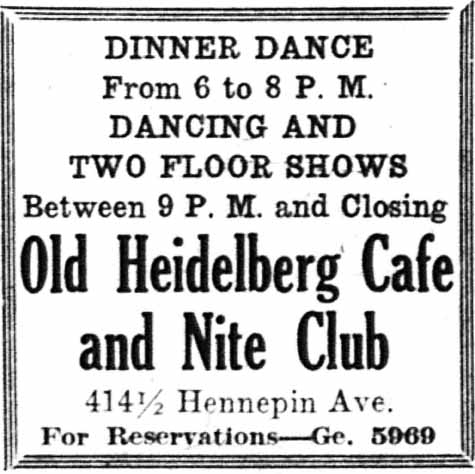
September 1933
On September 12, 1934, Manager Chuck Foster announced in an ad that the the Old Heidelberg Cabaret (formerly Schuster’s) was opening that day with two big floor shows nightly. A list of vaudeville acts was given, and the house band was Harold Betts and his Rhythm Boys. (Minneapolis Tribune)
The last ad in the major Minneapolis papers for the Old Heidelberg was found in December 1934, below.
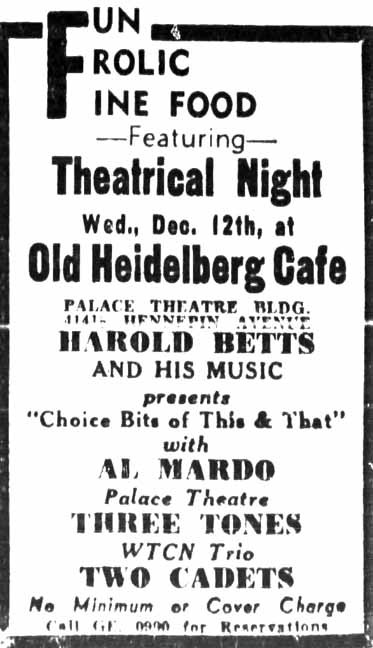
Minneapolis Tribune, December 11, 1934
Alas, the Depression likely put this business out of business, not to mention basement dining.
THE MINT
The Mint Night Club was operated by Meyer Gordon, a/k/a Morris, a/k/a Makey to the press, and Mickey on his ads. In one article he was described as a former football player. He had a cat and mouse relationship with the police’s morals squad. This club was definitely described as being “downstairs.”
The club opened on or before January 22, 1935.
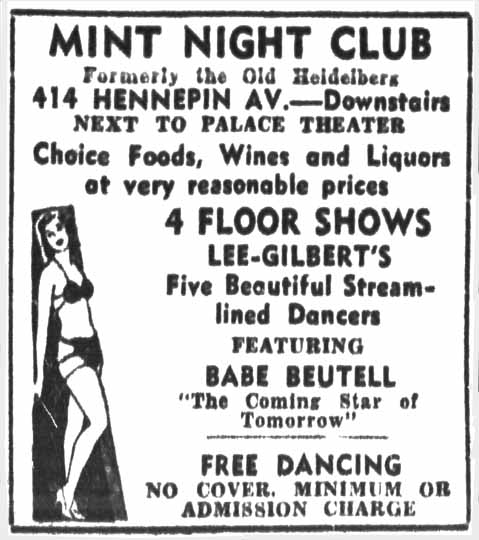
Minneapolis Tribune, January 22, 1935
In July 1935, cops from the morals squad made their rounds to the bars at the 2 am closing time, and Detective Walter Hansford, head of the squad, noticed that there was a considerable crowd still inside the Mint. He demanded admittance, but the proprietor told him that the doors was locked and gosh darn! the key was missing. Hansford sent for a crowbar, and wouldn’t you know, they found the key and no liquor was to be found! (Minneapolis Tribune, July 20, 1935)
But the next night, early Sunday morning, another raid resulted in the arrest of Makey Gordon, who was selling liquor after hours. Police noted that the place was packed at 1:15 when they made their move. Makey plead not guilty and the trial was set for July 24. He and another scofflaw from another bar were each fined $50.
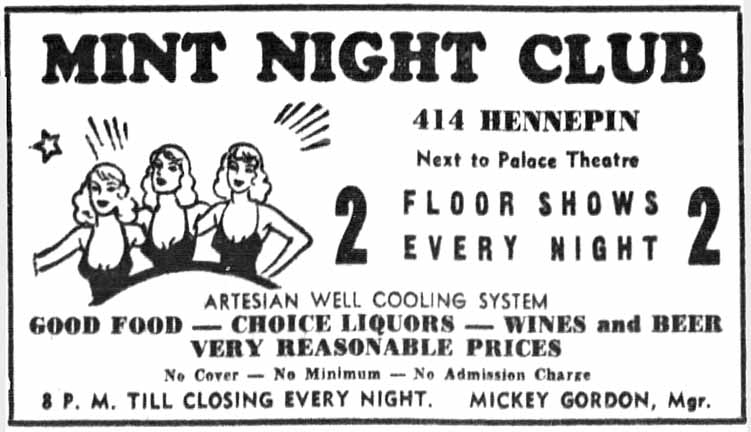
Minneapolis Tribune, August 17, 1935
Later that year, things really heated up at the Mint. The account in the Minneapolis Star says that representatives of the Minneapolis Retail Liquor Dealers’ Association came into the bar to sell tickets to a banquet planned by the liquor dealers at the Club Lido. Apparently they were not welcome, because the pair were beat up by employees.
Then, two police officers came to make sure that the bar closed at closing time. They testified that they were “set upon and beaten.”
Up to that time, there had been arrests at the Mint for violations of the liquor laws: one conviction, one acquittal, and one charge was dismissed. (Minneapolis Star, October 9, 1935)
As a result of this violence, Morris (“Izzie”) Garber, one of the proprietors, was locked up and charged with assault and battery. This charge was dismissed.
Also arrested were doorman Thomas Lunde.
Bartender Robert Hill was charged with selling liquor without a license, plead not guilty, and posted $100 bail. (Minneapolis Star, October 10, 1935)
If that weren’t enough trouble, on December 12, waitress Myra Thompson was arrested for selling liquor after hours. She pleaded guilty and was fined $10. (Minneapolis Star, December 13, 1935.)
That was it. On December 28, 1935, Mayor Thomas E. Latimer revoked all licenses for the Mint, following three convictions. The Grand Jury wanted to know why the place was still open despite the fact that Macey Gordon had transferred his liquor license to Patrick J. Monahan, one of his bartenders, on December 13, 1935, to take effect on January 1, 1936. (Minneapolis Star, December 28, 1935)
On January 1, 1936, the Mint opened again “under new management.”
Ah, but trickery doesn’t bode well by the police. On January 4, 1936, the Chief of Police came to shut it down, but the vampire of clubs wouldn’t die until January 6, 1936, when the Grand Jury ordered the place shut for good. Patrolman Joseph E. Kolars and Thomas P. Flaherty received the order from Captain George Hillstrom to put a stake through its heart.
ENLISTED VETERANS OF AMERICA POST 11
At this point the owners of the building (at one point named as George Benz’s Sons) began renting out the space, perhaps beginning in May 1946. One group that rented it often was the Enlisted Veterans of America, Post 11.
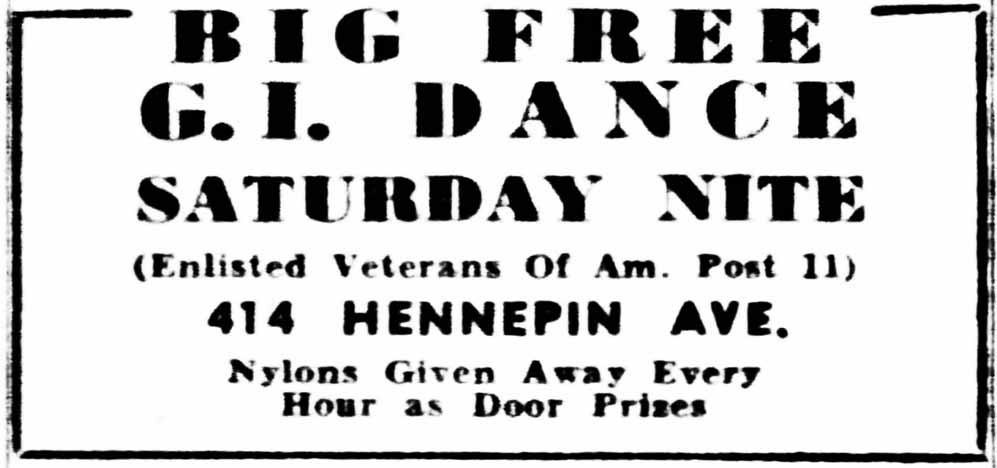
Minneapolis Star, Friday, June 21, 1946
The organization had been put together by a man who went by the name of Al Firotto, born Alexander Fecarotta, a/k/a Ray Farrell. He had been a hero in the War, but had a shady reputation in Minneapolis. The police had unsuccessfully raided the place several times, but on February 10, 1947, a police woman came in and said she was waiting for her boyfriend – a busboy – to get off of work. She was able to buy a drink, although Firoito had no liquor license, and she signaled the morals squad to raid the place. They found 42 bottles of booze.
Fiorotto was arraigned on February 11, 1947, and scheduled for trial on the 14th. His defense was that he had no official connection with the club. He was convicted anyway, and sentenced to 90 days in the workhouse, but since the manager was actually his brother Robert, the judge gave him the benefit of the doubt and stayed his sentence. The club didn’t last much longer, though.
ALAN STEPHAN HEALTH STUDIO
An article dated May 17, 1947, states that body builder Alan Stephan (“Mr. America”) had opened a health studio at 414 1/2 Hennepin Ave. This was in the basement of the Theater, as it appears in the photo below.
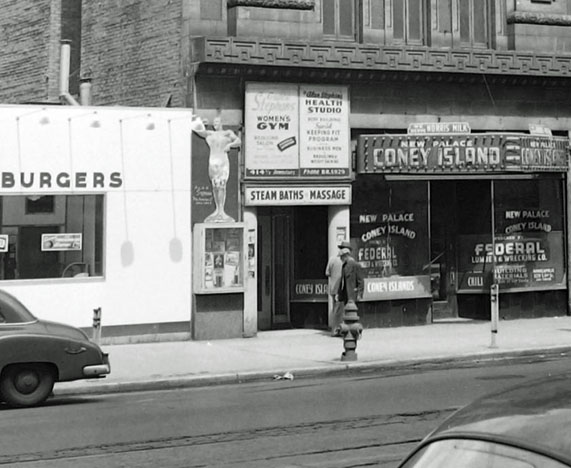
Photo taken on May 25, 1953 courtesy Minnesota Historical Society
Stephan met his fiance, Grace Pomazal (“Miss Legionaire”), at a personal appearance in Chicago, and they decided to settle down in Minneapolis. (Minneapolis Star, May 28, 1947) The couple married on June 16, 1947, at the Basilica of St. Mary, and after the honeymoon up north, the bride, also known as “Miss Quick Freeze” and “Miss Forget Me Knot,” planned to work as her husband’s receptionist at the health studio.
Alan, who was named “Mr. America” in a contest in New York sponsored by the International Federation of Body Builders in November 1948, met Miss America BeBe Shoppe a month later, and proceeded to hoist her on his shoulder for the cameras. (Minneapolis Tribune, December 29, 1948).
Stephan was at this address in 1953, but by 1955 he had moved to 704 Hennepin. (The theater was demolished in 1953.)
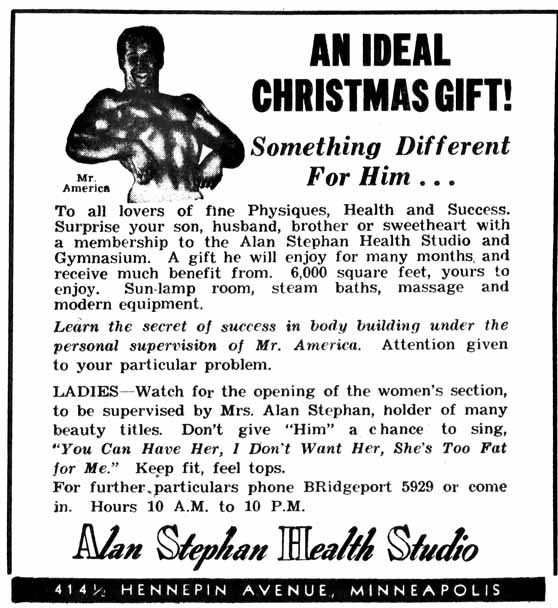
Minneapolis Times Picture Paper, November 20, 1947
A search to find out whatever happened to Alan finds him at three locations in 1958, under the name American Health Studios, a chain. (Minneapolis Tribune, February 24, 1958) And in a 1973 article in the Tribune about health club chains, he complained that a gym chain from Houston used unfair methods to run him out of business, and then the chain itself went out of business. (December 30, 1973)
This, lesser known Gay ’90s bar was in the Frederick Hotel at Fifth at Cedar Streets in St. Paul.
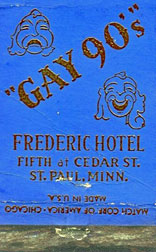
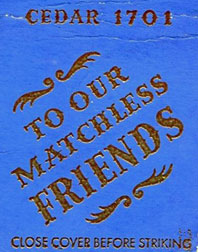
The Gay Nineties Tavern was located at 40 Washington Ave. in Skid Row.
This was probably just a bar in Skid Row, not to be confused with the Gay 90’s on Hennepin Ave.
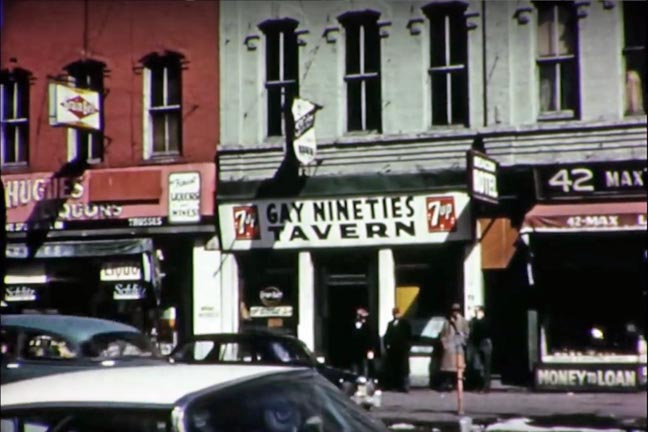
From John Basich’s films of Skid Row
Who knows if it had music, but with a name like that, something must have contributed to its happy theme!
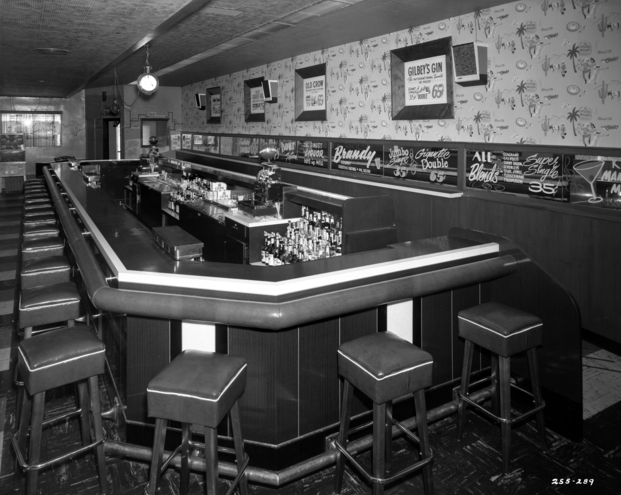
Photo courtesy Minnesota Historical Society
As with the rest of Skid Row, this property was razed. In 1965 a huge apartment complex was built with the address 222 Hennepin Ave.
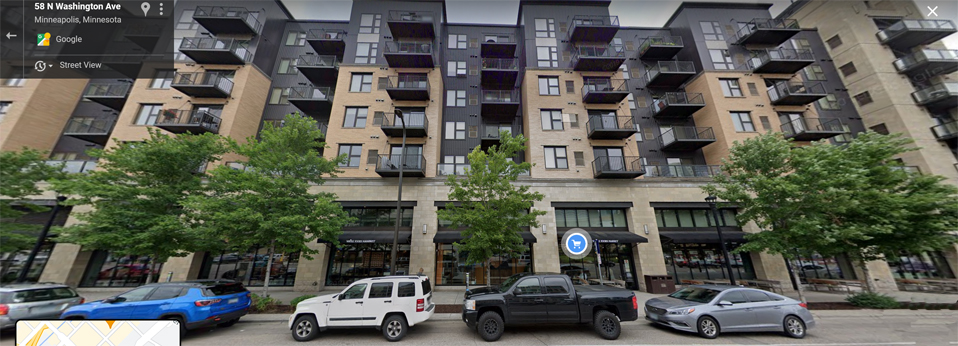
222 Hennnepin Ave
Please see Moonlight Gardens.
The Gayety Theatre was located at 103 Washington Ave. No. in Minneapolis. The site was originally built in 1886 as the Windsor House Hotel. The theater was built in 1909 but no demolition is noted, so it may have been a remodel of the hotel?
Bryan Krefft of Cinema Treasures.org provides the following information.
The Gayety Theatre was opened by Herman Faehr in 1909, originally as a legitimate house, and could seat just over 1,200. It was designed in Neo-Classical style, and its proscenium arch rose seventy feet above its stage. The facade, which featured a pediment held up by a quartet of Corinthian pillars, was of gleaming white terra-cotta.
By the mid-teens, the theater had switched to vaudeville and burlesque acts. During the 1920’s, among the famous names to play the Gayety Theatre included Al Jolson, Fanny Brice, and Sophie Tucker.
One notable burlesque act at the Gayety was Carrie Finnell, seen below, early in her career. Carrie may not look like much, but by all accounts had the ability to spin her tassels without moving her body. How that translated to radio, I don’t know.
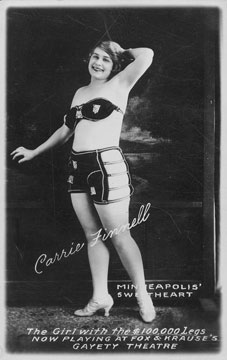
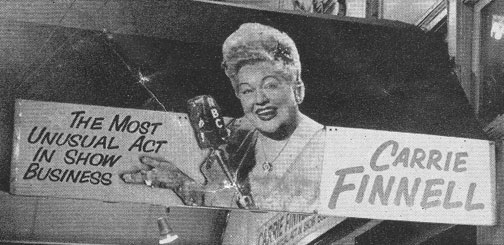
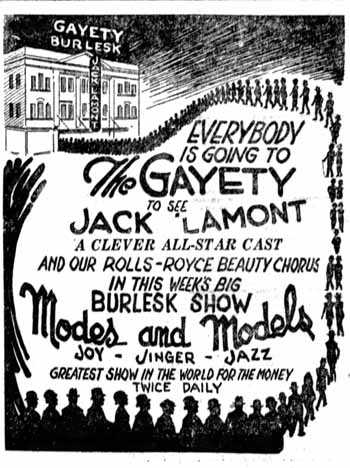
Minneapolis Daily Star, September 1924
The city of Minneapolis closed down the theater in 1928, after it decided the burlesque acts at the Gayety Theatre were becoming too racy. It was only after its management promised to stage musical comedy acts onstage rather than burlesque that the theater was allowed to reopen the next year.
In 1941, after nearly four decades of live entertainment, the Gayety Theatre finally turned to movies, as a double-feature house. In late-1941, the theater’s name was changed to the Floyd B. Olson Theatre, named after our Governor who died in 1936. However, when Olson’s widow learned her husband’s name was now on the marquee of the former burlesque theater, she sued the theater, which immediately switched the name back to the Gayety Theatre, and Mrs. Olson dropped her suit.
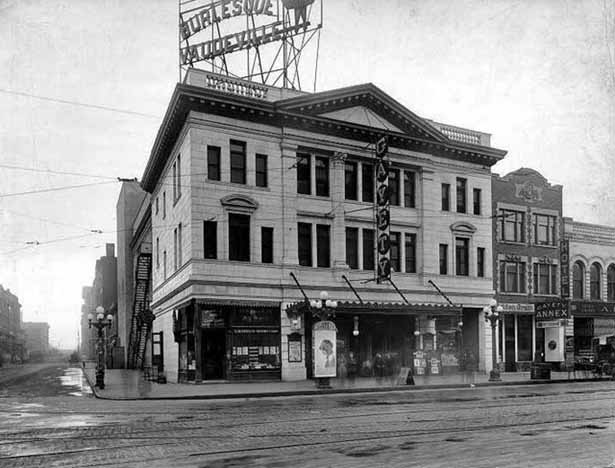
Courtesy cinematreasures.org
In the mid-1940s, the theater closed again, this time permanently. In 1945, plans were drawn up to convert the Gayety Theatre into a nightclub, but fell through.
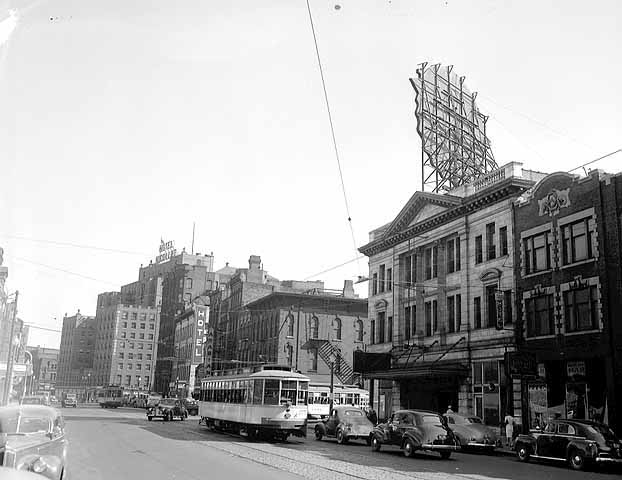
Washington Ave., 1944 – Minnesota Historical Society
Then, in 1970, after sitting vacant for decades, it was announced that legitimate theater would be returning to a restored Gayety Theatre, but once again, nothing came to fruition. The theater was razed by 1980.
In 2019, 101 Washington Ave. No. is shown as vacant land.
George Faust’s was located at 5916 Excelsior Blvd. in St. Louis Park from October 1968 to 1971. It was one of many descendants of the El Patio/Cotton Club. It was preceded by Culbertson’s.
Please see The Park Terrace.
Lyndale Place just north of Olson Memorial Highway. Jazz venue owned by Ben Wilson (who left town in the late ’40s).
The club at 1605-07 Nicollet Ave. went through several iterations as music venues. This page tells the entertainment history of the building as the:
- Gladstone Garden
- Original Flame Theatre Lounge (not to be confused with the Flame Cafe)
- Hoop-D-Doo
THE LORING BUILDING
According to one account the building was built in 1915, although permit cards seem clear that an original building was moved to this spot from 105 Ninth Street So. in 1890, and that construction began on a brick store and office building in 1921/22. It was a two-story building – originally the second floor had a mix of apartments and an occasional business, and later just offices on the second floor. When the building was demolished, its footprint was 142′ by 68′.
This venue is a bit hard to pin down, as there are two adjacent addresses, and they start out separate, but are advertised by both addresses later on. They were probably joined in 1941.
1607 NICOLLET
This space was apparently very large, with a stage, rehearsal hall, Opera Hall, dressing rooms, etc.
From December 1921 to August 1922, it was the Opera Hall of the Edwin Skedden American School of Opera.
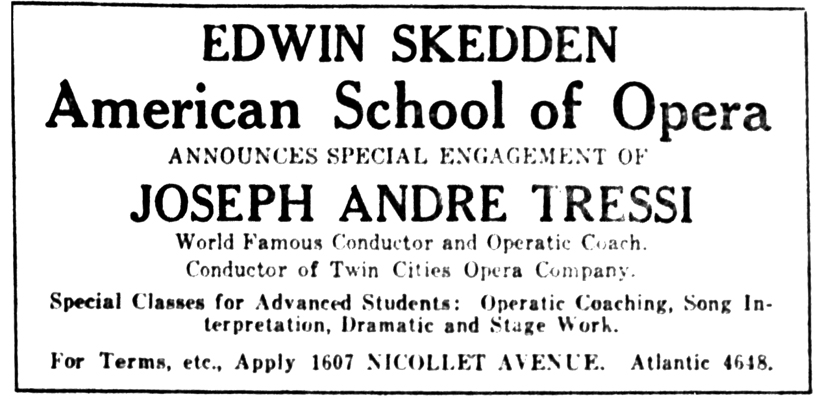
Minneapolis Tribune, April 9, 1922
In September 1922, it was leased to the McPhail School of Music and Dramatic Art. This apparently lasted until August 1923.
September 10, 1923: Caserta School of Dancing took over the space.
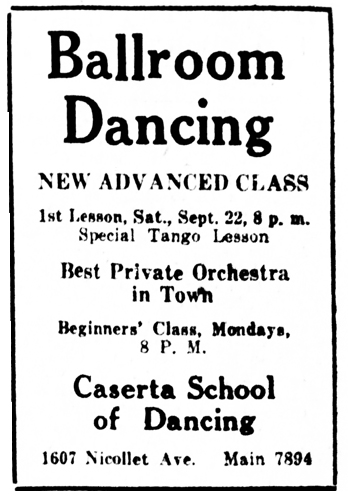
Minneapolis Tribune, September 21, 1923
September 1924: Howe School of Music
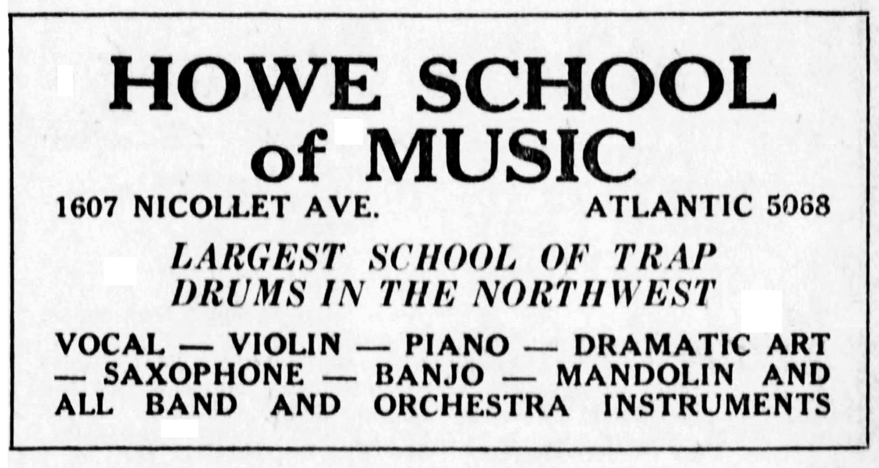
Minneapolis Star, August 29, 1925
In December 1932, 1607 Nicollet was the address of a tabloid newspaper called the Brevities, then embroiled in an extortion plot.
In January 1940, it was Gould Music Studios.
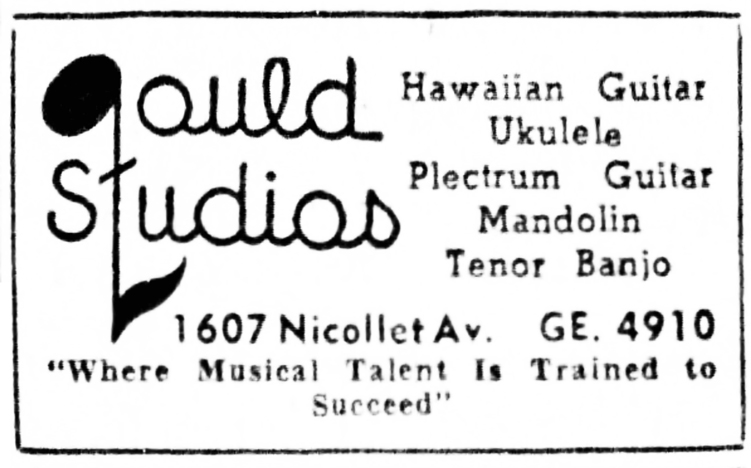
Minneapolis Tribune, March 17, 1940
WEIRDNESS IN THE HALL
An adjunct of the hall with the same address was the home of several sequential organizations with names like the Unity Society of Right Thinking and several psychic societies. In November 1951 there was an ad for something called the “Metaphysical Truth Center,” led by Reverend Prince Yogi. Alas, Yogi was unmasked as one Lawrence Day, a convicted bootlegger. The city attorney told the jury that “A fortune teller or like imposter is a vagrant under the law.” With tongue in cheek the Star reported that “The jury retired then and settled Day’s future” by sending him to the workhouse for 90 days.
1605 NICOLLET
GLADSTONE GARDEN
In January 1923 to January 1, 1930, Gladstone Lunch was owned by Thomas V. Pappas; he later added a partner named Jack Keprios.
On January 1931 it was called Gladstone Garden Lunch.
By December 1932 it was simply Gladstone Garden – by all appearances just a restaurant, “open all night.”
In March 1934, at a hearing for application for a liquor license, a City Alderman pointed out that the Gladstone was “the oldest cafe on Nicollet Avenue.”
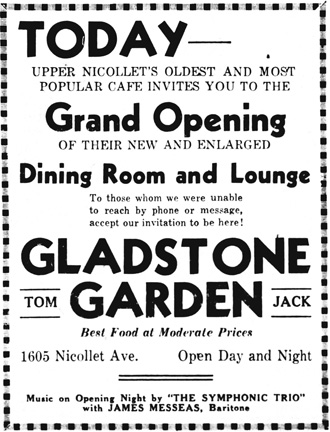
Minneapolis Star, December 5, 1935
$2,000 in alterations were made to the cafe at the end of 1938/beginning of 1939.
In August 1941, Tom Pappas wanted to transfer his liquor license to a building he wanted to build at 133 East Lake Street (at Stevens), which would be a tavern and bowling alley. The proposal was dropped after much community opposition. (The area is apparently under 35W now.) (Minneapolis Tribune, August 6, 1941)
In February 1942, 1605 Nicollet was altered at a cost of $2,300. At this point my assumption is that 1607 was added to 1605 to make a larger club.
In March 1942, Cedric Adams reported in his “In This Corner” column that Benny Harris had put $25,000 into the building and was intending to call it the Flame. “Harris, who in the old days had such spots as Boulevards of Paris and the Plantation, dickered recently for Harry’s Cafe.” (Minneapolis Star Journal, March 18, 1942)
FLAME THEATRE LOUNGE
The next use of the building was the Flame Theatre Lounge, from 1942 to 1951. Since there were so many Flames, let’s call this the 1607 Flame, since that’s the address that was the most frequently used.
It opened on April 10, 1942, with Manager Ben Harris. The Flame featured vaudeville, jazz, and other types of music. An unsigned and undated memo (probably from the mid-to-late 1940s) indicates that the deed was held by one Michael Crakes but that the quit claim deed could be held by local gangster Tommy Banks.
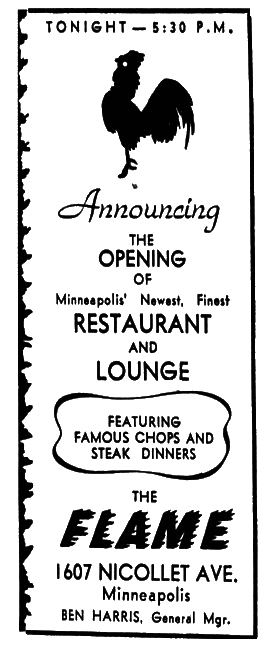
Minneapolis Star, April 10, 1942
Although it featured steaks and chops, a rooster seemed to be its mascot.
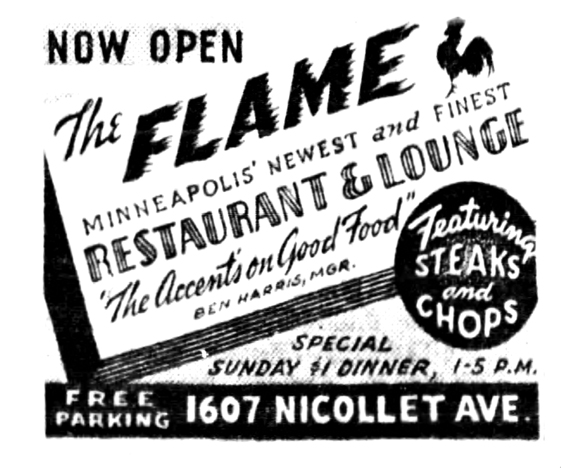
Minneapolis Star, May 15, 1942
On March 21, 1943, the Manager was Joey Swartz.
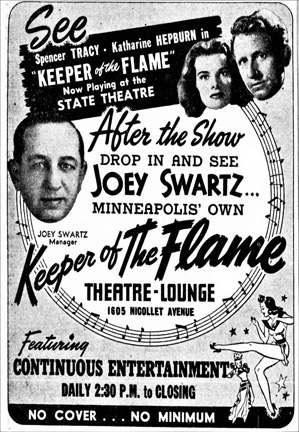
Minneapolis Star, March 26, 1943
In 1944, the place was advertised as the New Flame. These ads make it look like a fun place!
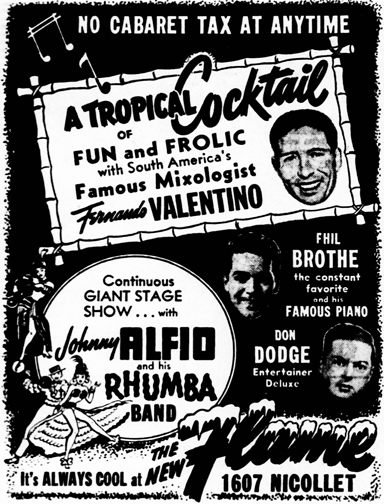
Minneapolis Tribune, July 2, 1944
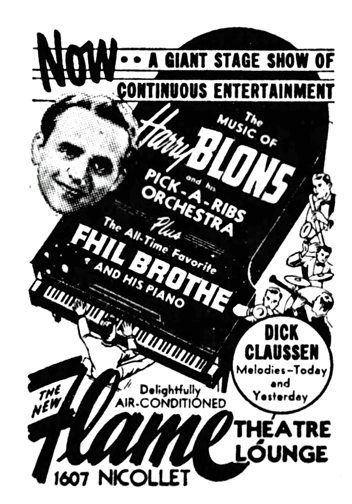
Minneapolis Star, July 12, 1945
Manager Joey Swartz was charged with attacking employee Elmer P. Fox on November 20, 1944, and Elmer tried to sue Joey’s wife Freda, the owner of the bar, for $8,500 in damages. Freda was covered by a worker’s compensation claim, but Elmer was awarded $1,000 from Joey, who was a former professional boxer and had taken out nine of Elmer’s teeth in the altercation. (Minneapolis Tribune, May 3, 1946)
The Flame went up in flames on July 21, 1947, but was quickly extinguished. It was confined to the rear lounge and damage was slight, although three windows were blown out.
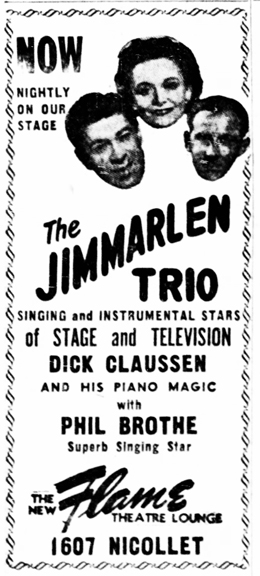
Minneapolis Tribune, July 30, 1950
TRANSFER OF THE FLAME
An article in the Trib dated January 18, 1951, indicated that Mrs. Freda Swartz operated the Flame at 1605 Nicollet, and requested the transfer of the Flame’s 3.2 beer license to the Club Carnival site at 1523 Nicollet, which was vacant at that time. Samuel Markowitz had been the assistant manager of the 1607 Flame, and planned to operate in 1607 Nicollet building. The old Club Carnival building would become the new Flame.
HOOP-D-DOO
After the Flame name was transferred, in about August 1951 the 1607 Nicollet club became a 3.2 beer tavern called the Hoop-D-Doo Bar and Cafe. The proprietor of the Hoop-D-Doo was Harry Ressen.
In 1951 there was a schedule of sorts at the Hoop-D-Doo:
- Wrestling matches on Tuesdays
- Amateur Shows on Thursdays
- Jam Sessions starting at 2 pm on Sundays. Stebbins: “This place quickly became a congregating point for jazz musicians both local and out of town, and it was not uncommon to have national stars sitting in with the [Bob Davis house] band.”
In August 1952 the tavern was raided by the morals squad, which yanked out six girls accused of being underage. (Minneapolis Tribune, August 8, 1952)
In August 1953 an irreverent account told of “Hoop-la at Hoop-de-doo,” in which two patrons mixed it up and Ressen tried to stop the fight and eject the aggressor. Instead, both fell through the plate glass window of the front door. Then, to make matters worse, the first patron came out and “bopped” the other guy as he lay on the sidewalk. Harry had cuts on his legs and thighs, and the other guy had a broken nose. (Minneapolis Star, August 8, 1953)
In 1954 the Hoop-D-Doo made news again when an alert waitress overheard a 6′ 6″ robber making a plane reservation to Detroit. They caught him at the airport. (Minneapolis Tribune, January 19, 1954)
CHAR-BURGERS
In May 1954, Cedric Adams commented on the merits of the tavern’s char-burger, perhaps the first in the Twin Cities. Soon afterwards, the place was called the Char-Burger AND the Hoop-D-Doo. (Minneapolis Tribune, May 30, 1954)
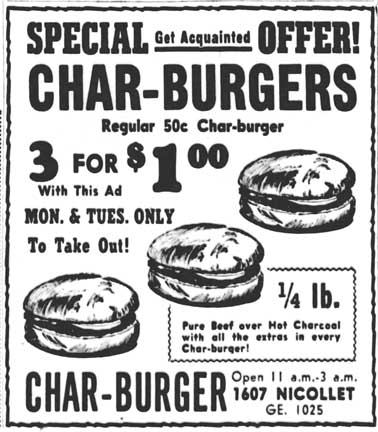
Minneapolis Star, October 16, 1954
In July 1954 the upstairs Valor Hotel was padlocked as a public nuisance for prostitution. Ressen had sold the hotel license and furniture to Frank E. Thew, and Thew was given 90 days in the workhouse for keeping a brothel. (Minneapolis Tribune, July 15, 1954)
Things were getting ugly – Chester LaRue got a glass bottle poked in his eye and risked losing it after he bumped into a guy holding a glass bottle. Let’s hope the docs at General Hospital were able to save Chester’s eye. (Minneapolis Star, October 23, 1954) The guy charged with wielding the bottle was acquitted. (Star, February 8, 1955)
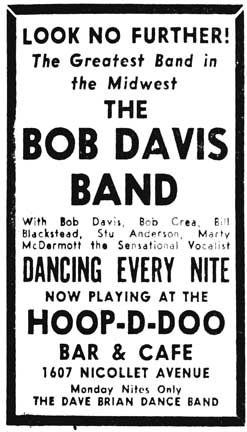
Minneapolis Tribune, November 26, 1954
In May 1955, Will Jones commented about the char-broiled food, but also that it was the only 3.2 joint with a strip teaser. This bears an extended quote:
The girl doesn’t work up on a stage to be gawked at from a distance. She does her work on the dance floor, at customer level, surrounded by customers. A beefy little number named Ginger is the current attraction. Bob Davis’ band supplies the music.
The non-paid dancers, or customers, are frequently as entertaining as the paid one. All this entertainment is available to any citizen with the price of a 20-cent tap beer, which price includes the cabaret tax. I don’t think bargain is too strong a word to use here.
But unfortunately for Miss Cathy Carson, the morals squad deemed her costume too skimpy and her dance too suggestive. All she had on when she was arrested was “a few beads in one place and a G-string and a small amount of fringe in another,” said Jake Sullivan, head of the morals squad. Miss Carson plead guilty and paid her $100 fine, but defended herself by saying that she had asked how far she could go when she first hit town, and was told “as far as I like.” Said Sullivan, “Someone misinformed her.” (Minneapolis Star, July 23, 1955)
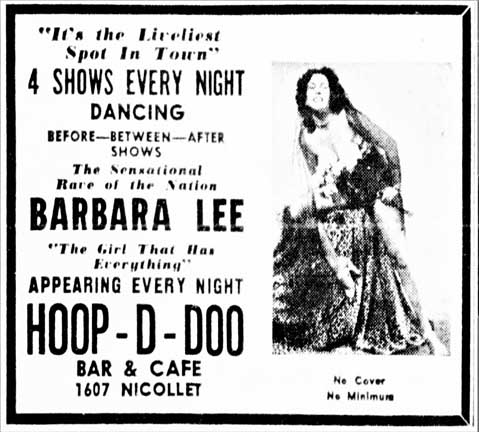
Minneapolis Tribune, October 22, 1955
In November 1955, building owner Leo Villas announced plans to totally remodel the building. After dentist A. Arnold Axilrod, who had had an office upstairs, was convicted of killing one Mary Moonen, perhaps it needed an exorcism. Renovations were reported to be in the area of $125,000 to $150,000. At the time, the second floor was occupied by professional offices. The main floor had 10,000 square feet, divided into eight retail stores. (Minneapolis Tribune, November 6, 1955)
Below is a photo of how it looked in about 1956. The Char-Grill and the Hoop-D-Doo are in the third section from the left, with the large protruding sign.
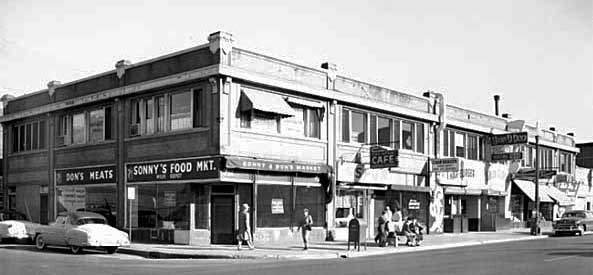
1956 photo courtesy Minnesota Historical Society
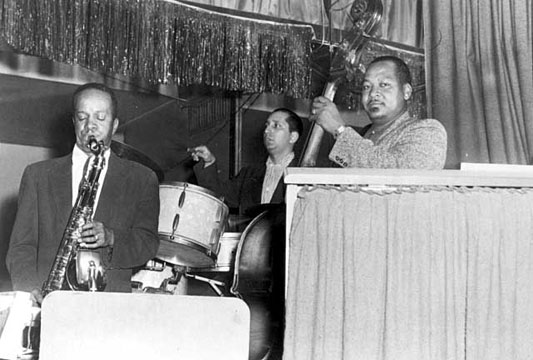
Hoop-D-Doo jazz session, September 1956, courtesy Ira Pettiford/Minnesota Historical Society
Mrs. Helene Ressen (was Harry dead by now?) was given a 30 day suspension of her licenses for selling beer to a minor. The original committee recommendation only called for a ten-day suspension. (Minneapolis Star, December 1, 1956)
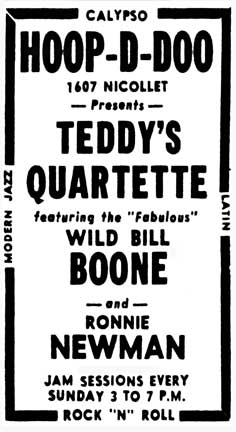
Minneapolis Star, March 14, 1957
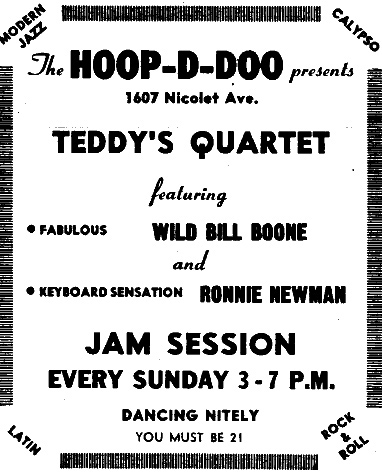
Undated Minnesota Daily ad, courtesy Robb Henry
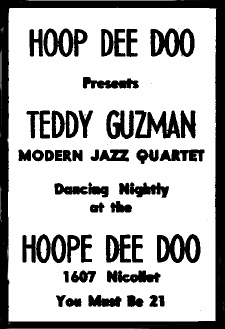
Undated Minnesota Daily ad, courtesy Robb Henry
FIRE ONE
On August 6, 1957, the “liveliest spot in town” became the “hottest as well” when a three-alarm fire hit the building, burning out eight business, including the Hoop-D-Doo. Caretakers Mr. and Mrs. Frank Molumby lived in an apartment in the building, and firefighters had to break down their door to rouse them. The fire was preliminarily found to have been started “in the back of the Hoop-D-Doo, in an arm of the tavern” that ran behind a vacant beauty shop. (Minneapolis Star, August 6, 1957) Permit cards show $18,000 in repairs and alterations.
KING’S LANES
After the fire, part of the building, including the part that had been the Hoop-D-Doo, was converted into a deluxe bowling alley. The building permit for that alteration was dated January 28, 1958, and the construction cost estimate was $15,000.
The bowling alley opened in about April of 1958. Amenities included:
- Six bowling alleys on the second floor
- Eight bowling alleys on the first floor
- A nursery with babysitters
- An entertainment room with TV and movies
- A billiard room with five billiard tables
- A restaurant that could seat 100 patrons
Why this Grand Opening ad below was placed in 1959 is unclear, unless bowling alleys were only open seasonally:
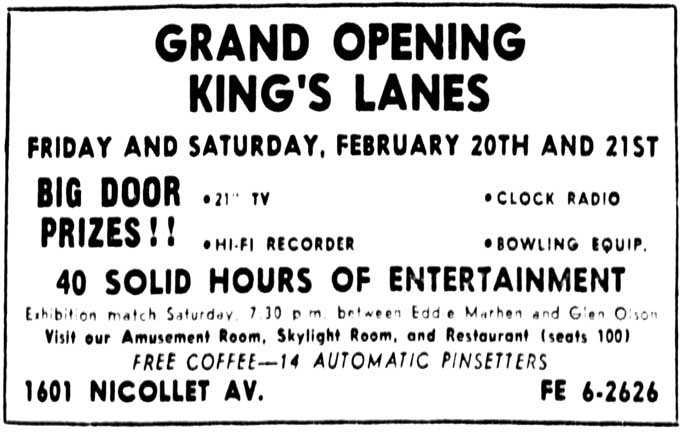
Minneapolis Tribune, February 19, 1959
FIRE TWO
Well, by now the building was truly cursed. On April 18, 1960, another three-alarm fire erupted on “the second floor in the back end of the bowling alleys and in a cockloft” – specifically in a storeroom with wooden pop cases and “a quantity of paper cartons of matches.” Smoke was extensive throughout. Owner Leo Villas lived on the second floor above the bowling alley and had to be treated at General Hospital for smoke inhalation – twice he tried to go back into the building before being restrained. Damage amounted to about $200,000. The building permit set the estimate of repairs at $10,000 plus wiring, plumbing, etc.
FIRE THREE
The bowling alley was relatively unscathed by the 1960 fire and was reopened. But disaster hit a third and final time on April 15, 1963 – this time a four-alarm fire that burned out of control for four hours. This time the roof collapsed, and the the first floor collapsed into the basement. The bowling alleys from both the first and second floors were found in the basement the next morning. Damage was estimated at $500,000.
Owner Villas finally gave up the ghost – the building was torn down in July 1963.
County tax records indicate that the site is now vacant; I-94 runs directly south.
Gleason’s Inn was located on Central Ave. NE (Highway 5) near New Brighton. It was there since at least August 20, 1926.
In 1932 Ed Gates was the proprietor and their ad in Twin City Brevities invited us to Dine and Dance!
As time went on, the distance from “the loop” (downtown Minneapolis) seemed to get shorter and shorter as the ads progressed.
In about July 1931 it became the Rainbow Inn, except for maybe a week in November 1934 when it was called Mulligan’s Inn (formerly Gleason’s Inn).
St. Paul. 1947
Please see Tafi’s.
This delightfully fun sounding nightclub was located at 14 5th Street N in Minneapolis.
On April 21, 1939, Hennepin County Sheriffs raided the Golden Bubble and took proprietor Marie Critelli into custody for maintaining gambling devices, specifically “chuck-a-luck” and Bingo. The case was dismissed when it was pointed out that there was a partition between the gambling area and the bar!
June 1940 Golden Bubble Cafe
The Golden Fox was located in Brooklyn Park. It didn’t move, but its address often did. And those multiple addresses often overlapped!
February 1969 to ? (used in event calendar ads) : 71 1/2 Ave. N. and Highway 152
April 1969 to February 1970: 73rd and Osseo Road
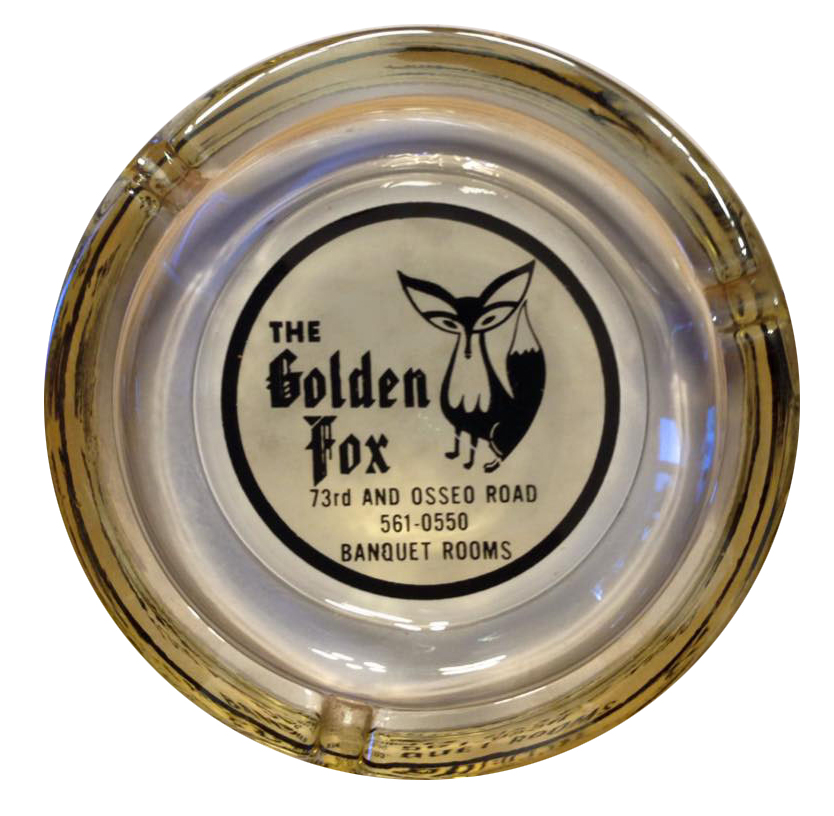
From the collection of Mark Youngblood
7300 Brooklyn Blvd.: July 1971 – December 1977. This became the address of Park Center High School.
February 1972 to April 1979: 7355 Regent Ave No.
An ad dated February 2, 1969, said that Jim Corniea and Dwight Olson did an outstanding job getting the Golden Fox ready for the grand opening, which saw 1,000 guests.
The facility had a main dining room, two cocktail lounges, and four lower banquet rooms. Apparently a dance band was in one of these rooms.
On April 21, 1969, Will Jones reported on his visit to the Suburban venue , and reported that Jim Corniea was the owner, and he and some of the staff had owned the Office, a club in Downtown Minneapolis.
JIMMY BOWMAN
By that time, Jimmy Bowman was playing piano in the cocktail lounge. Or the piano bar. Were the one and the same? Jimmy told Will,
It’s a whole new crowd out here in the country. Most of them never got downtown to see me. I don’t think some of them have ever been downtown. I’m doing a lot of the same stuff I was doing when I started at Freddie’s 11 years ago, and it’s all new to them. And the old customers keep asking for it.
Jones adds,
And he keeps doing it: the Calypso numbers, and the hipster versions of such historic events as Chris Columbus’s affair with that groovy chick, Isabella.
A 1969 ad shows the Jimmy Bowman Duo (with Duffy Goodlowe) in the lounge. In January 1970, Bowman issued an album called “Jimmy Bowman Swings at the Golden Fox,” although it was recorded at UA Recording, 2541 Nicollet.
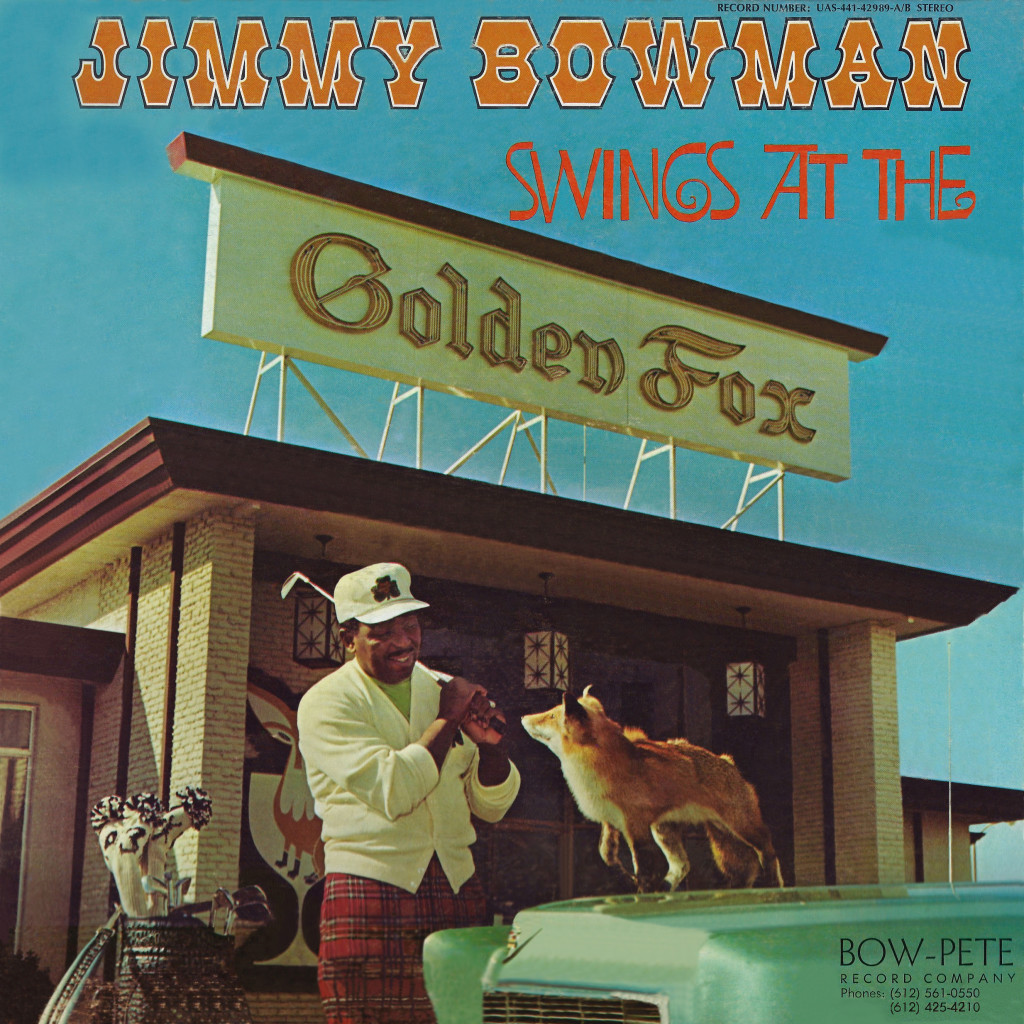
Amazing job of retouching by Steve Brown!
OWNERSHIP
Ownership soon changed, and by at least November 1969 the proprietors were Rudy and Marvelle Peterson. Weekly ads had messages signed by “Rudy.”
On February 28, 1971, Peterson announced that he was taking on a partner because his main occupation was real estate development. Instead, he sold the business to John Muchulas and John Boosalis. The new owners were announced in an ad dated September 19, 1971. The chef and menu were changed, and the restaurant was opened up on Sundays.
DAVID CARROLL AS ELVIS
The premiere Elvis impersonator in the Twin Cities was David Carroll, and it appears that he began his longstanding gig at the Golden Fox in about March 1972. (Five years before the real Elvis made his final Aloha..) He called his act David Carroll and the Magic Touch with his Tribute to Elvis.
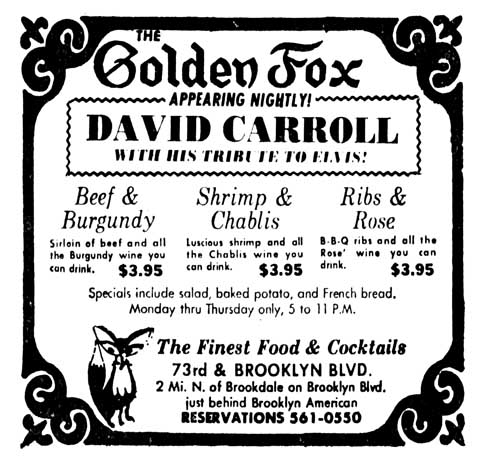
Minneapolis Tribune, October 9, 1973
Below is an odd, handmade ad, seemingly a one-off.

Minneapolis Star, October 8, 1974
On July 27, 1975, the Golden Fox, American Legion Post 630, and Gordon’s Supper Club served alcohol to Richard Ronnei, who was already visibly drunk, in violation of the Dram Shop Law. Ronnei was then in a hit-and-run accident that killed David and Patricia Dristel, leaving their two children orphans. Police found Ronnei, and he did time in the Workhouse. The three bars were required to pay a settlement to the children, to become available to them when they became 18.
On November 26, 1975, the Star’s Jon Bream went bar hopping in suburbia and included the Golden Fox in his travels. He said the restaurant
has an unpretentiously classy bar with a warm atmosphere. The L-shaped barroom, with an elevated dance floor at the corner of the L, has plush booths and red carpeting on walls decorated with tacky, gold-gilded shields.
On weekend nights the Golden Fox bar is crowded with stylish, self-conscious, seemingly monied white-collar suburbanites in their 20s. There are couples and unaccompanied people – some eyeing company – but the Golden Fox does not have a pickup bar atmosphere.
The band plays creative, contemporary, not-too-loud rock and the dancers respond with enthusiasm and excitement.
A mixed drink in a lowball glass costs $1.20 and was the tastiest drink at the bars listed in the area.
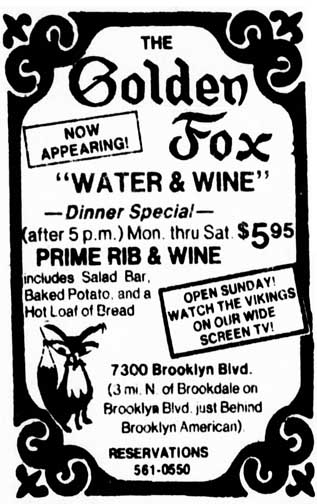
Minneapolis Star, September 16, 1977
The last classified ad for help at the Golden Fox appears to be dated April 1979.
In August 1979, a Chi-Chi’s Mexican Restaurant opened in its place.
901 Cedar Ave. So. was the site of two music venues:
- The Golden Leaf Bar
- Whiskey Junction
THE BUILDING
The two story brick building was built by Paul Scherving in 1894 as a saloon, presumably run by Jens Rice.
With the advent of Prohibition in 1920, the building became a factory and rooming house, according to the permit cards. The Whiskey Junction website offers:
At one time the second story was divided in to several small rooms and was rumored to have been a brothel, but this rumor has never been confirmed. However, the rooms were rented to railroad employees from the rail yards that were across Cedar Avenue, where the Light Rail Station now is. This rail yard was the end of the line for trains coming from North Dakota and the employees would spend the night in the rooms and re-board the trains in the morning for the return trip home.
The establishment had moonshine problems and even its soft drink license was revoked in September 1921. That didn’t stop Charles Edman, proprietor, and he got caught again in 1923, operating without a license.
In 1925 it had a food license, issued to Frank Nelson. In 1926, Mayor Leach himself revoked Nelson’s license on recommendation of the police. In May 1927 a license was awarded to Bert Thompson.
NEW STYLE BARBEQUE
In December 1928 the cafe was called New Style Barbeque. In May 1933, at the very end of Prohibition, a soft drink and restaurant license was awarded to Mrs. Elizabeth Shropshire, and in December 1933 it was the New Style Southern Barbeque. A liquor license was awarded to Thure B. Backman in February 1934.
GOLDEN LEAF BAR
By May 1934, the establishment was called the Golden Leaf Cafe. By January 1935, and perhaps from the start, the bar was owned by Albin E. Gillquist, as evidenced by an item about a liquor license violation.
On November 8, 1935, a column purporting to be written by Walter Winchell read:
Mr. and Mrs. Minneapolis have the habit of tepeeing at the Golden Leaf – where out-of-towners stop too. The band here provides some torrid tootlings – and if you like hot hoofing, you’ll take the gal there soon.
By November 1947, Oscar G. Pearson was listed as the “operator.” In October 1949 the liquor license was transferred from Oscar Pearson to Elmer “Al” Halvorson and Ervin J. Holland. Halvorson was Pearson’s brother-in-law, according to the Whiskey Junction website. In June 1952 the liquor license was transferred to Silas Holland and Elmer H. Halvorson. Elmer Halvorson was cited as the owner in 1961 and 1967.
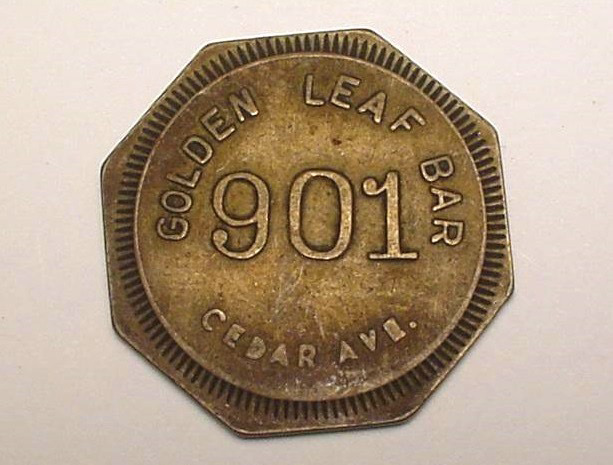
Elmer Halvorson died in September 1973 at the age of 61. In his obituary he was described as the former owner of the Golden Leaf. In April 1976, Craig E. Pearson took over the bar. The Whiskey Junction website says that at the age of 21, he was the youngest bar owner in Minnesota.
Musician Al Foran remembers the Golden Leaf as a neighborhood bar, where on the weekends you could hear the strains of the accordion, concertina, or a fiddle.
WHISKEY JUNCTION
In August 1984 Gary MacKenzie and Peter Tayalo purchased the bar for $225,000.
Music began to be advertised at Whiskey Junction in August 1985.
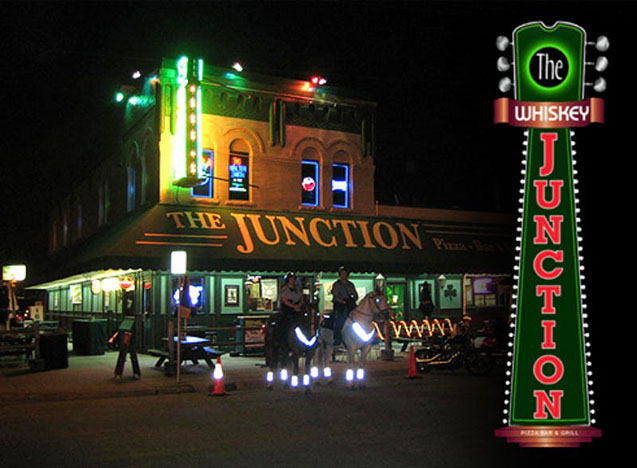
This page covers three venues at 52-54 So. Seventh Street in Downtown Minneapolis:
- The Golden Pheasant
- Meyers Inn
- The Running Fox
THE BUILDING
52-54 South 7th Street was a three story brick building built in 1893. Typical of its time, it had storefronts on the first floor and apartments/a hotel on the upper floors. Its footprint was 44′ by 157′. It was built at a cost of about $10,000, according to the building permit.
A note about addresses: Although the ad below says that the address of the Golden Pheasant was 52-54-56, the official address of the building according to the permit cards is 52-54. 56-60 is a separate building. Now whether the Golden Pheasant was in 52, 54, both, or upstairs, is a mystery, especially since there were two businesses at one time in 52, as we’ll see later on. The other restaurants listed below were both at 52. The building is gone and so is everyone who ever went to the Golden Pheasant, so it may remain a mystery.
GOLDEN PHEASANT
The Golden Pheasant Inn opened on December 21, 1919. An early restaurant license indicates that it was on the second floor of the building. The Grand Opening ad was so large that I’ll post it here in three pieces. I apologize for the quality of the photos on this page, but they were probably scanned from yellowed copies of very old papers, and my photoshopping skills are limited!

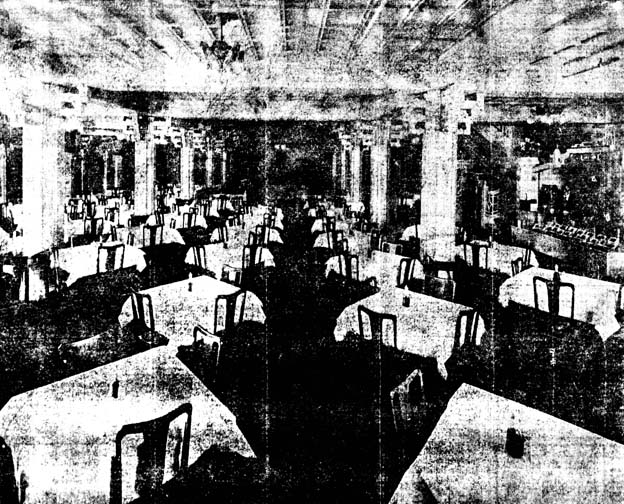

Minneapolis Tribune, December 21, 1919
The restaurant was owned by Golden Pheasant, Inc. The officers of the company, as stated on the first ad, were:
- John Eng, President
- P.Y. Lee, Vice President
- Lester S. Lee, Secretary
- Frank W. Hong, General Manager
In July 1920, the Golden Pheasant was threatened with a lawsuit by the publisher of a song called “Just Like a Gypsy,” which their orchestra had been playing in a jazzed-up style. The Remick Music Company alleged that the sales of their sheet music had decreased because of the playing of the song. (Minneapolis Tribune, July 17, 1920) No follow-up found.
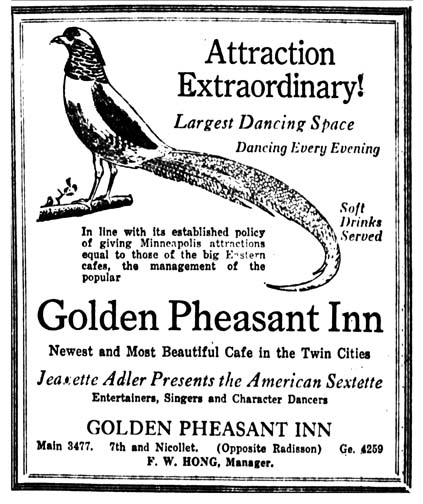
Minneapolis Tribune, October 10, 1920
On December 25 and 26, 1920, the Inn presented Hohoano’s Hawaiians, Famous Native Musicians, with Princess Kiona, “Hula Hula Dancer.” Unfortunately the ad is too dark to reproduce!
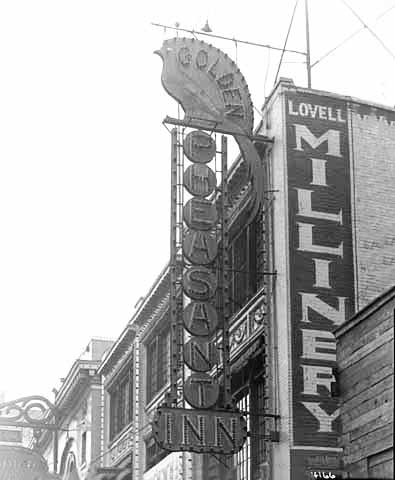
Golden Pheasant Inn, 1921. Image courtesy Minnesota Historical Society
In March of 1922, the Golden Pheasant, called a “chop suey house” by the Minneapolis Daily Star, was a key player in the murder of Hong Lee, killed at the outbreak of the Minneapolis tong war. Lee was killed at the rear door of the Hip Sing tong headquarters, 717 Third Ave. So., on March 7. He had a piece of paper with the address of the Golden Pheasant in his pocket, and was wearing a suit made in Boise, Idaho, which indicated that he was a newcomer to Minneapolis. The proprietor of the Golden Pheasant was said to be the secretary of the Hip Sing tong. This may have been Frank Hong. This is a whole other subject that bears exploration. Frank Hong and the Golden Pheasant are discussed in an article in the Minnesota Monthly called “Citizen Hong,” by Joseph Hart, August 23, 2006.
On December 30, 1923, four people were arrested in a raid by Federal Prohibition officers at the Golden Pheasant Inn. One was an adult, and the other three were high school students. (Minneapolis Tribune, December 31, 1923)
In December 1923, the name of the place appears to have changed from the Golden Pheasant Inn to the Golden Pheasant Cafe. It was always owned by the Golden Pheasant Inn, Inc.
Sam J. Heiman’s Golden Pheasant Orchestra was broadcast in June 1924 on WLAG radio, but WLAG went offline on July 31. The orchestra went back on the radio when WLAG became WCCO on October 2, 1924, and remained on WCCO’s schedule for the rest of the year.
In 1925 the house band was Emmet Long’s Golden Pheasant Orchestra. Emmet Long was the younger brother of Dick Long, who was known for his career leading the Nankin Cafe Orchestra, the Shubert Theater Orchestra, and others. During World War I, Emmet was the director of the orchestral branch of the 1st Engineers’ Band of Washington, DC. He later took over his brother Dick’s position as leader of the Strand Theater’s orchestra.
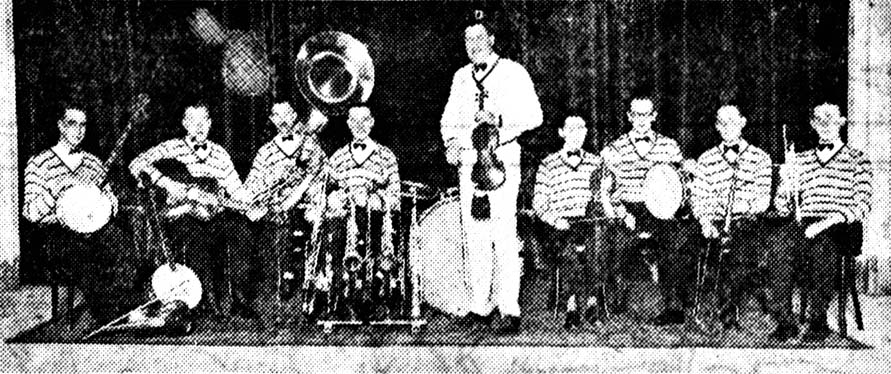
Emmet Long’s Golden Pheasant Orchestra. Minneapolis Daily Star, October 3, 1924
In June 1925, the Golden Pheasant’s dance hall license renewal was held up pending investigation of “reports against the place” by the police, and all dancing was forbidden until things were cleared up. (Minneapolis Daily Star, June 27, 1925) The application was denied four times in two months.
Music was broadcast from September 1925 to June 26, 1926, by Emmet Long’s Golden Pheasant Orchestra on WCCO radio.
A notice printed in the Minneapolis Tribune on June 28, 1926, announced that the cafe would be closed for renovation and open no later than September 4, 1926. It was signed by James Woo, Manager.
In July 1926, the orchestra was led by Emmet Long and could be heard on WCCO radio.
In January 1927, the Minneapolis Daily Star began a serial called “Sonia” written by Vida Hurst, which featured the Golden Pheasant in its storyline. As a promotion, the paper planned a big party for anyone named Sonia in Minneapolis and the immediate suburbs, starting at the Golden Pheasant and making the rounds to the city’s leading theaters. One article described a plane that would drop fliers advertising the event. (January 11, 1927)
In May 1927, the Golden Pheasant Orchestra was led by E.A. Sodal.
In September 1927, Walt Anderson and His Hoodlums were engaged to provide music for the Golden Pheasant. The September 10, 1927, article announcing their arrival described the “newly opened Golden Pheasant Cafe for the fall and winter season.” (Minneapolis Daily Star)
The “Hoodlums” included:
- Les Baker (or Backer)
- Eddie Bratton
- Norm Hendrickson
- Dick Hall
- Art Swalin
- Harry Wood
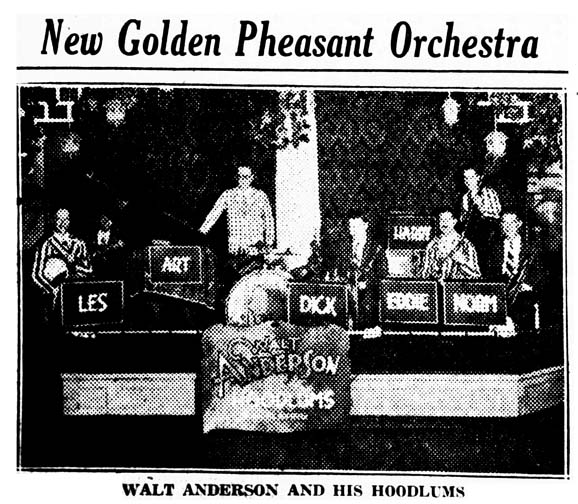
Minneapolis Daily Star, September 10, 1927
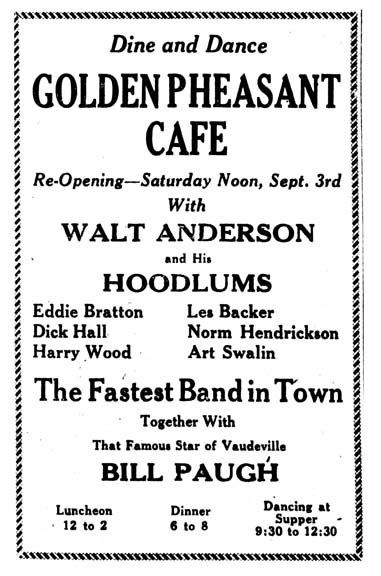
Minneapolis Tribune, September 3, 1927
In 1927 Walter Anderson and His Golden Pheasant Hoodlums made a recording of the song “Melancholy” at the Lowry Hotel in St. Paul.
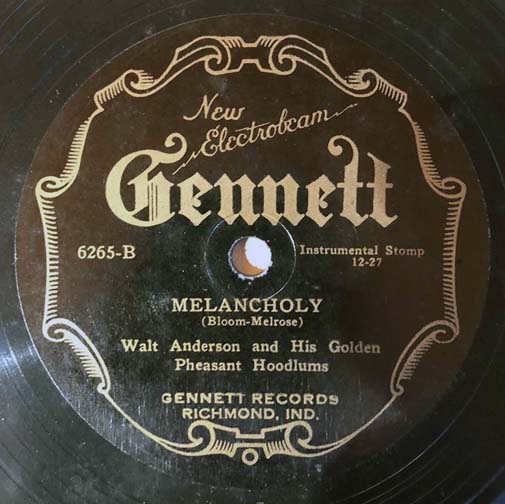
Image courtesy Hans Eekhoff via Jonathan Horne
From December 1927 to March 1928, they had a regular broadcast on radio station WAMD, the forerunner to KSTP.
The Golden Pheasant’s dance hall license application had a lot of problems in 1928. First it was held up in April because the Alderman in charge of approving renewal had heard reports of alcohol being consumed on premises. (Minneapolis Star, April 27, 1928). Then it was rejected because of “immoral dancing” reported by the police, but it was an effort to force the City Council to make a study of all dance halls on this important issue. (Minneapolis Tribune, July 1, 1928) The immoral dancing consisted of “indecent wriggles.” (Minneapolis Star, June 29, 1928)
Music was broadcast from the Golden Pheasant over KSTP radio in July 1928.
The Golden Pheasant Cafe “Opened for the Season” on September 15, 1928, at noon. Music was provided by Walt Anderson and His Golden Pheasant Cafe Orchestra.
“Revelers Pay for ‘Fun’ With Municipal Fines,” the headline read on January 3, 1929. Two young men were each fined $15 for disorderly conduct for acting disorderly at the Golden Pheasant over New Year’s Eve 1928, definitely a Prohibition year. (Minneapolis Tribune)
In January 1929, an investigation of Aldermen concerning bribes came to the doorstep of the Golden Pheasant when owner Henry Woo was called to testify before the grand jury concerning his efforts to secure a dance hall license for the cafe. (Minneapolis Star, January 29, 1929)
Golden Pheasant Inn, Inc. filed for bankruptcy in April 1929.
At this point it’s difficult to say what was where. At 52 So. Seventh Street we also see:
A.G. Spalding & Bros. 1926 – 1937
After that came Linpark Clothes, from March 1939 to April 1959.
MEYERS INN
Meyers Inn was opened at 52 So. Seventh Street by Joseph G. Meyers. He had transferred his liquor license from his place at 27 So. Fourth Street, which he had run since at least 1939. Rogers Stage Bar had been a girlie show place in the Gateway, according to Will Jones, and Meyers took the redevelopment as an opportunity to relocate and establish a respectable restaurant. Meyers made $18,000 in alterations to the space and opened “quietly” in about February 1960. Jones’ review only talked about the food – no mention of entertainment. (Minneapolis Tribune, April 3, 1960)
By July 1960, Joe realized that he needed some entertainment, so he brought in Cecilia Dupree and her Escorts, reported Don Morrison, filling in for Will Jones. Cecilia was described as a “looky French girl with a Bardot hairdo,” etc. etc. (Minneapolis Tribune, July 8, 1960) Cecilia later wrote in thanking Morrison for not calling her “sexsational,” so she could send the clipping home.
RUNNING FOX INN
In 1962, an “ailing” Joseph G. Meyer sold his business to Fred L. Armstrong, Jr. The former Meyer’s Inn was opened as the Running Fox on March 13, 1962.
A new piano bar was called the Den, with Don Dodge presiding.
The smaller dining room cut the menu from 222 items to 35. Will Jones reported: (Minneapolis Tribune, March 12, 1962)
Armstrong said he will add special game dinners to the menu, with the game supplied by Armstrong Ranch, his father’s shooting club near Anoka. The new decor will include a couple of stuffed red foxes in rakish attitudes, the work of a taxidermist with a sense of humor. Armstrong’s background as saloon-keeper-restaurateur includes four years on the staff at the Normandy and a year at Michael’s.
A review in February 1963:
A relative new-comer to the list of fine downtown Minneapolis restaurants. Decor is based on English fox hunt theme and menu specialties feature exquisite game bird dinners, when in season… Lively convivial piano bar plus combo entertainment.
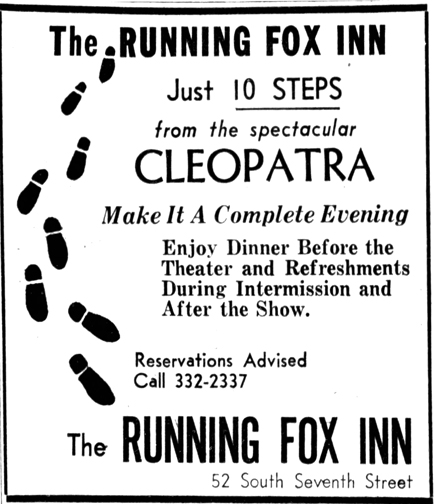
June 30, 1963
In late 1963 Armstrong sold the Running Fox to “four local business and professional men. None had had any previous restaurant experience, but they say they are having fun learning.”
The downstairs room was called the Foxhole, described by Will Jones as a “relatively small, low-ceilinged room.” (Tribune, January 9, 1964.
MEYERS INN
Apparently it didn’t work out, as the place reverted to Meyers in December 1965, and it was again called Meyers Inn.
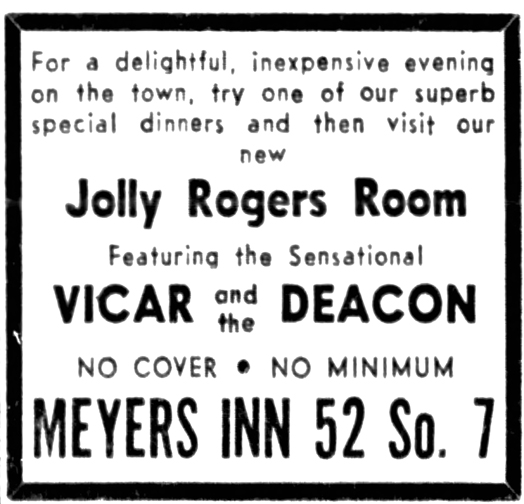
August 19, 1966
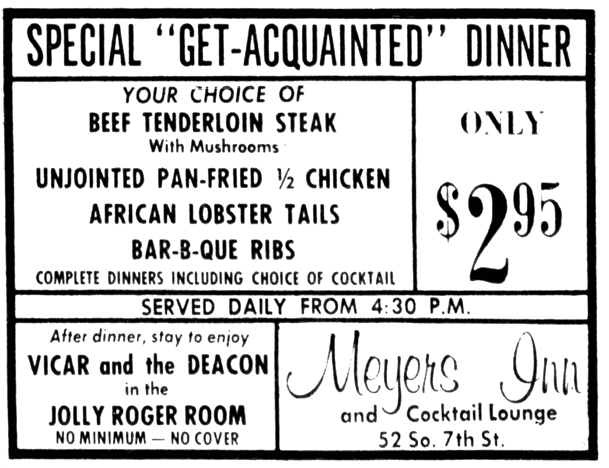
August 25, 1966
George Griak appeared in the piano bar in February 1967, followed by Dick Miller in March 1967.
In September 1967, “Master Showman” Paul Moore was on piano, vocals, and comedy detail.
Barbara Thompson followed in the piano bar from the end of 1967 into 1969.
On November 12, 1968, a five alarm fire destroyed the Kresge building at 628 Nicollet Mall. Meyers Inn was one of the businesses listed as damaged by smoke and water.
The last entertainer shown (and the last mention of Meyers Inn) was Betty Kent in August 1969.
Meyers died on December 6, 1970.
The building was demolished in October 1979.
The Golden Steer Restaurant and Lounge was built in 1961 in South St. Paul and featured artists like Cornbread Harris.
It closed in 1998.
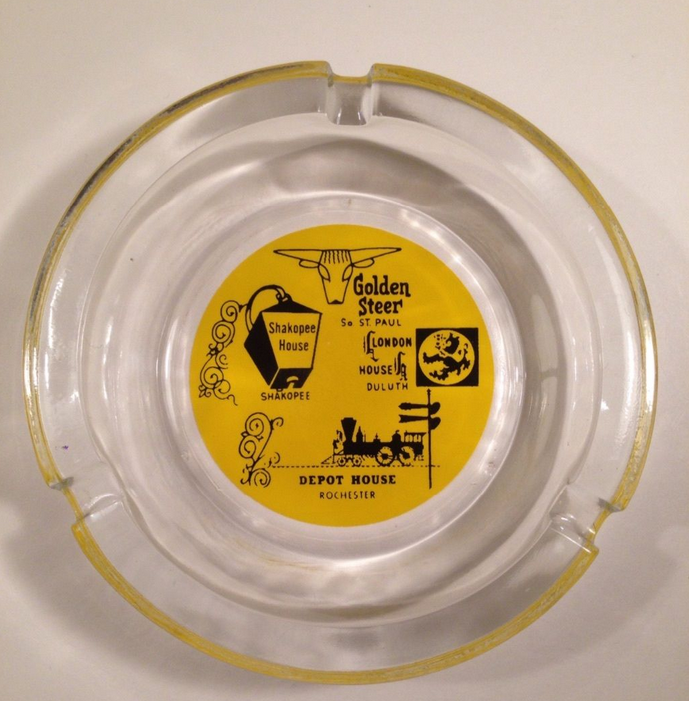
Please see Blue Goose Inn.
Please see the Sheraton Ritz Hotel.
Gordon’s in the Park was located at 7725 Zane Ave. in Brooklyn Park.
The first item found in the Minneapolis Star about Gordon’s in the Park was in December 1967 when it was approved for serving liquor on Sundays, but it would not take effect in time for New Years Eve. (December 15, 1967)
In 1969, the venue was the site of art exhibits.
The house band was Up Front for many years.
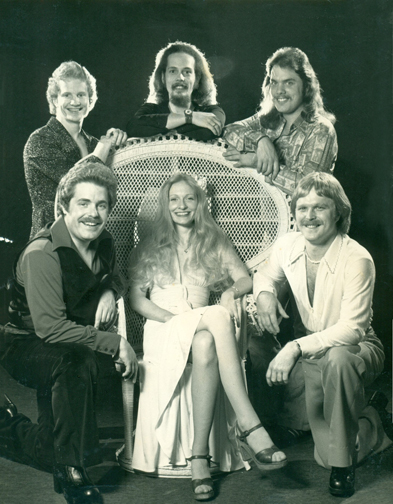
Up Front in 1977. Image courtesy Greg Haage (standing, upper left)
Indications are that the bar lasted until September 1987, and possibly until May 1992.
7725 Zane Ave. No, Brooklyn Park.
GORDON’S SUPPER CLUB
1969: Jim Feeney Trio featuring Earl Pritchard, dancing nightly.
Mark Youngblood posted these two items from the Gramophone Cafe – I have no idea if it had music, but with a name like that, it counts, okay? I also tried to find out where exactly it was, but given just an intersection and no earthly idea when it existed (no hits on the Minneapolis newspaper database), my best guess is the newish building at 590 Park Street.
What was interesting was when I did a search for W.R. Frank. He turned out to be a movie theater mogul, who, by 1944, had interests in 17 theaters around town and was building more. Bored with that, and apparently getting quite rich from that, he was also producing movies, starting with 1944’s “The Life of Dr. Paul Joseph Goebbels,” (renamed “The Enemy of Women”), 1945’s “A Boy, a Girl, and a Dog,” and 1949’s “The Great Dan Patch.”
“Bill” Frank also got into the restaurant business, pairing them with his theaters. These included the Boulevard Twin and the West Twins. First you ate, then walked over to see the movie. No entertainment – the movie was the entertainment!
One of the last ventures I found was a place called the Inferno, a club at the Tremont Plaza in Hopkins that opened in about 1972. These ads featured little devils…
Anyway, here’s to W.R. Frank, and his Gramophone Cafe!
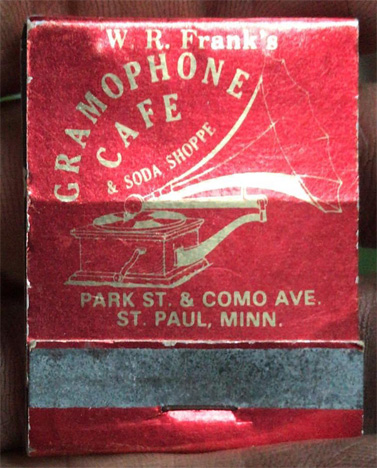
From the collection of Mark Youngblood
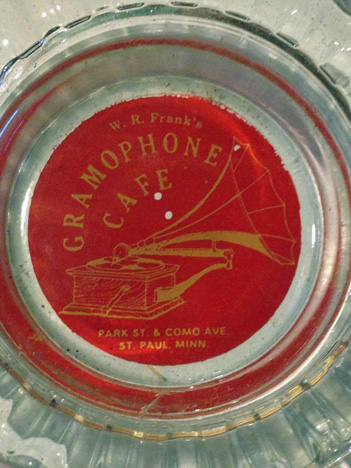
From the collection of Mark Youngblood
The Grand Opera House was located near the corner of Nicollet and Sixth Street in Minneapolis. It offered both plays and concerts.
In 1883 it was recognized that the Academy of Music was inadequate to meet the needs of the public. To replace it, “the Syndicate,” a wealthy corporation, devoted a portion of its new Syndicate Block to an opera house, at a cost of $175,000. The architect was a Mr. Cobb, “one of the leading theatrical architects of the country.” It was located on the ground floor of the building, with separate exits from each gallery. (Daily Minnesota Tribune, January 1, 1883)
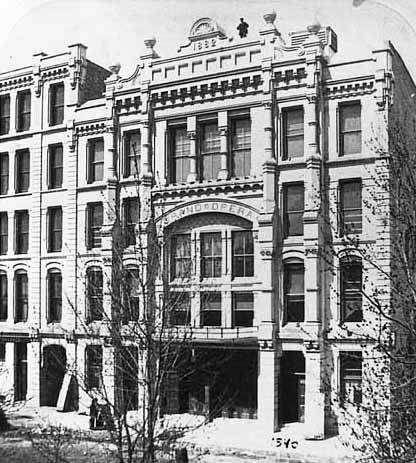
Building exterior, 1885 – photo courtesy Minnesota Historical Society
The building had a seating capacity of about 1,600. Its manager was J.F. Conklin; stage manager was A.R. Brann; orchestra leader was Frank Danz, Jr.
The first performance was on April 2, 1883, with the Amherst Glee Club. Four years later it was redecorated by Mr. John S. Bradstreet.
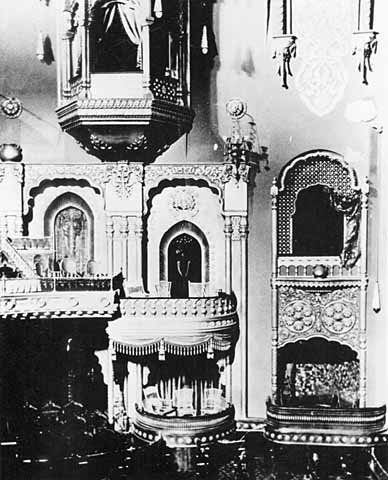
A view of the inside, 1883. Photo courtesy Minnesota Historical Society
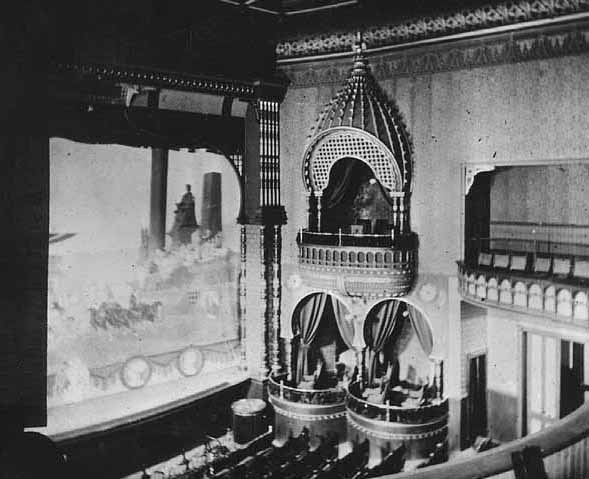
A view inside the theater, 1890. Image courtesy Minnesota Historical Society
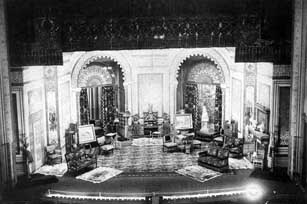
The stage in 1890 – photo courtesy Minnesota Historical Society
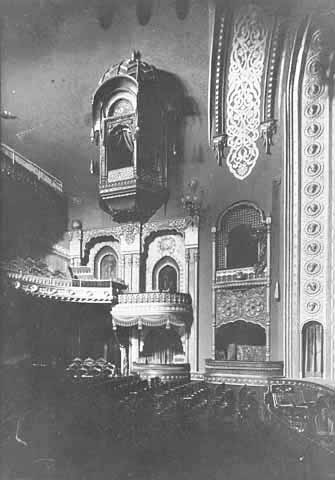
Another inside view from 1893 – photo courtesy Minnesota Historical Society
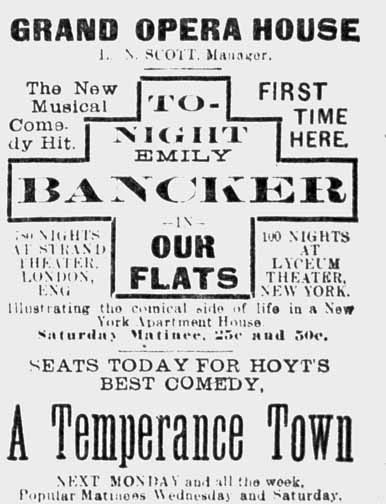
January 17, 1898, Minneapolis Tribune
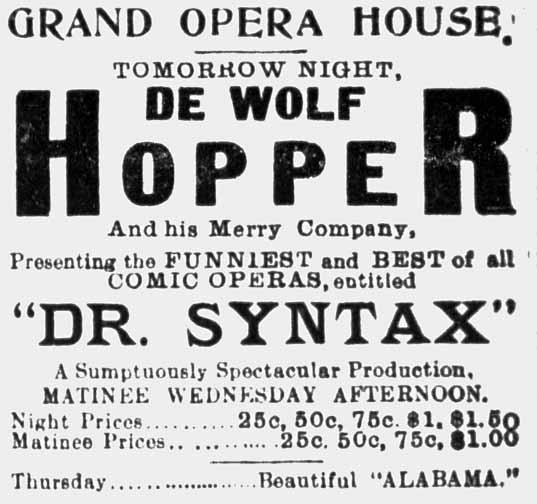
Minneapolis Tribune
CLOSING OF THE OPERA HOUSE
On September 20, 1895, the Minneapolis Tribune announced that the Grand would be closing. Apparently the City could not support as many theaters as it had, and a deal had been struck to transfer the Grand’s bookings to the Metropolitan Theater.
The Grand Opera House closed on October 5, 1895, with Hoyt’s ” A Contented Woman” being its last play. Its bookings were transferred to the Metropolitan Opera House, which had opened the preceding year as the New People’s Theater. In 1897 the Grand Opera House was completely demolished and a retail shop erected on the site. (Minnesota History article “Early Minneapolis Theaters,” Randolph Edgar, 1938)
An article confirms that the old Opera House was “completely torn down and replaced with a new annex in 1898.” Postcards into the 1950s still show the same exterior, as shown below at right, so the facade may have been preserved. (Minneapolis Tribune, March 6, 1911)
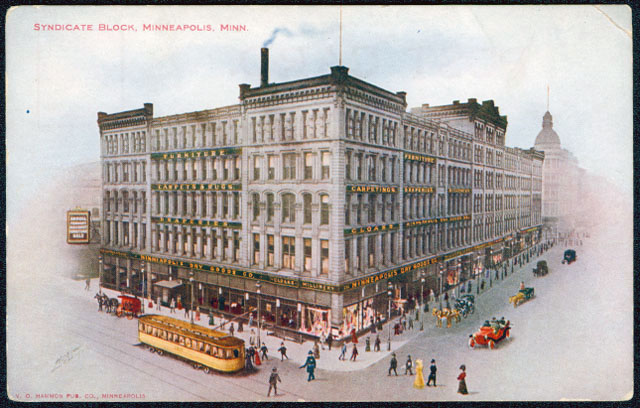
Syndicate Block, 1910. Photo courtesy Minnesota Historical Society
The first St. Paul Grand Opera House was apparently on Wabasha Street, and burned down in 1888.
The Metropolitan Opera House was built to replace it, opening on December 29, 1890. It was located at 100 E. Sixth Street in St. Paul.
A second replacement was the Grand Opera House, located at 34 E. Sixth Street. It also opened in 1890, by Milwaukee-born Jacob Litt. The Grand Opera House could seat around 1,200 amidst Beaux-Arts finery, including two sets of box seats, a large balcony and moderate-sized stage. Opening day included a speech by the Governor of Minnesota, and attendance by most of the leading families of St. Paul.
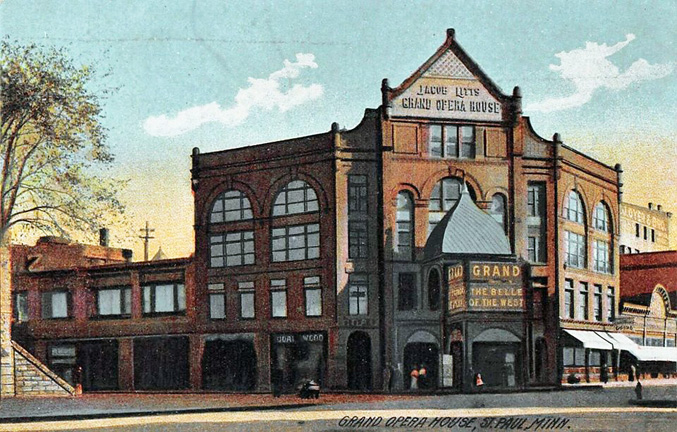
Grand Opera House, St. Paul, @ 1910s. From the collection of Mark Youngblood
Not only did the Opera House stage operatic fare, but musicals and legitimate theater as well, during the 1890s and into the first decade of the 20th century. The Opera House was also a venue for boxing matches, including appearances by such legends as John L. Sullivan and “Gentleman” Jim Corbett.
A fire in early 1912 destroyed a portion of the Opera House, but it was rebuilt and reopened later that same year as a burlesque house called the Strand Theater.
Two years later it was closed again and remodeled with interior decor based upon New York City’s Strand Theater. It housed a $5,000 pipe organ, had its own house orchestra, and a colossal electrically- illuminated roof-top sign. The Strand Theater became primarily a movie house, though it still continued to host live entertainment as well.
Very soon after, it received a final name change, as the Garrick Theater, and by 1926 was operated by the Finkelstein & Ruben chain. From the 1920s into the 1940s it was a first-run movie house, and in its early years the Garrick Theatre even had reserved seating and higher prices for box seats.
However, by the end of World War II, the Garrick Theater had definitely seen better days, and was showing B-grade double-and-triple features. Shortly after it closed in early 1950, it was razed to make way for a parking garage.
Research by Bryan Krefft, cinematreasures.org
This page was pieced together from Minneapolis permit records and information from Richard Varani at CinemaTreasures.org. No guarantees that I have interpreted the data correctly.
SAVOY THEATER
The Savoy Theater was located at 242 Hennepin Ave. at Washington Ave. No. The three-story building was originally a saloon, hotel, and restaurant, built in 1885. In 1919 the first floor was altered into a theater. Above the theater was the Grayfield Hotel, run by Betty “Frenchy” Ryan. The building was owned by Harry M. Dreyer.
The theater opened as a silent movie house, complete with organ and full orchestra. It turned into a venue for nudie films, was fraught with crime, and was apparently shut down after a raid in 1940.
GRAND THEATER
By 1946 it had been renamed Grand Theatre, run by Sam Berger. It was very small, had only a single aisle, and was very nondescript. Varani described it as:
a grind house operating every day from 10:00 am to 11:30 pm. The Grand Theatre specialized in showing burlesque and “girly” films, i.e. “A Night At The Follies”, etc.
In 1953 Berger paid a $100 fine for showing “French Peep Show,” under the alias “Parisian Burlesque.”
The Grand Theatre was a rare example of the projection booth being located behind the screen. Varani:
This was a straight on rear projection system. Screen was translucent glass. The projectors were set to a slight upward angle so the audience would not see a “hot spot.” Used a 2-½ inch lens. The throw (distance from the lens to the screen) was between 30 and 40 feet. In a normal operation the projectionists always worked with the sound track toward him/her. At the Grand we had to work with the sound track away from us. Worked many a shift in the booth during 1957-58. Booth equipt with Standard Simplex Heads, Peerless Low Intensity Arc Lamps, and Ultraphone Sound. Ultraphone made a special sound head to handle the sound track being on the other side.
242 Hennepin was demolished in 1961 as part of the Gateway clearance. In 2019 it remains vacant land.
The Grand should not be confused with the New Grand Theater that opened in 1911 at 617 Hennepin Ave. and lasted until about August 1929. That building was demolished in September 1979.
“New Fun House – Enjoy a Sensational Evening’s Entertainment” 101-107 Nicollet Ave. across from the Great Northern Depot. Ad in the Minnesota Daily October 1953.
The Great Lakes Bar and Fun House was on the corner of 1st and Nicollet, in the heart of old Skid Row. “No prudes allowed.”
Thanks, Jeff Lonto!!
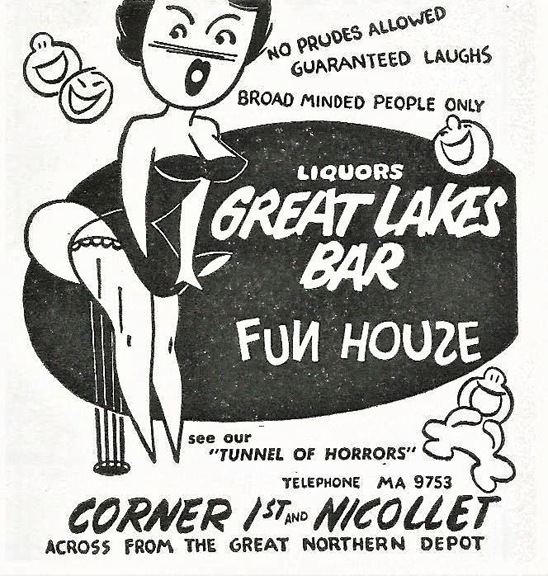
From a 1956 Minneapolis Millers game program (first season at Met Stadium)
The Great Lakes Bar was demolished in 1960 for the Gateway redevelopment project.
The Green Door was described as a Lake Conference Teenage Nite Club in 1960. Located on Excelsior Blvd. and Blake Road in Hopkins, it hosted the Bops and the Diablos, among other bands.
Green Gables was on Rice Street in St. Paul, four miles north of Larpenteur.
In 1932 you could Dine and Dance to Radio Sally and the Merry Melody Makers.
This is the story of the original Green Lantern of the 1920s. For the Green Lantern that existed in the 1970s, click here.
The Green Lantern! A mysterious place where nefarious goings-on… went on. Dave Matheney of the Minneapolis Tribune gave its address as 545 1/2 Wabasha in an article dated June 13, 1991.
And now, photos have emerged that give us a peek into this infamous speakeasy known for gangsters and violence and everything bad about Prohibition and the Dirty Thirties.
From the St. Paul Pioneer Press: Nick Woltman, April 13, 2019
Photos recently discovered appear to show notorious St. Paul gangster hangout Green Lantern
The Green Lantern, which closed in 1934, was the center of the city’s underworld and a magnet for criminals like Kid Cann, John Dillinger and Doc Barker. But no photos of the bar’s interior were known to exist, leaving historians and true crime fans to speculate about what the Wabasha Street watering hole was like.
And it might have stayed that way if a local hood hadn’t been shot to death outside its back door in 1931.
A handful of crime-scene photos recently discovered in the files of the St. Paul Police Historical Society appear to depict the Green Lantern during its heyday. Its dirty floors and cramped booths undermine the glamorous myth of the city’s gangster era, painting a grittier picture of life on the wrong side of the law.
Jeff Neuberger, the amateur historian who found the photos, believes they were shot for use as evidence in the murder trial of John Quinn, who was convicted of killing Frank Ventress in the alley behind the Green Lantern.
Neuberger, who has worked as a custodian for the St. Paul Police Department since 2000, has scoured police and property records to support his conclusion.
“It would be a huge deal to have photographic evidence of the Green Lantern,” said Paul Maccabee, whose 1995 book John Dillinger Slept Here was the first comprehensive chronicle of St. Paul’s Prohibition-era crime wave. “It would be a cause for celebration among crime historians.”
The Green Lantern was the linchpin of the city’s infamous “O’Connor System,” named for then-Police Chief John J. O’Connor, who invited criminals from across the country to lie low in St. Paul as long as they behaved while they were in town.
America’s most wanted would check in at the Green Lantern when they arrived, and the bar’s proprietor would pass along their information to the city’s corrupt police force.
When Maccabee was researching his book, he searched high and low for photos of the legendary speakeasy, which was demolished decades ago to make way for an apartment complex.
“I was never able to find photos,” he said. “It was a hangout for killers and crooks, so that’s not so surprising.”
SHEDDING LIGHT ON A DARK ERA
Most police records from this dark period in St. Paul’s past were destroyed as the department digitized its files in the 1970s and 1980s. A precious few were rescued from the trash by history-minded officers and handed over to the St. Paul Police Historical Society when it was formed in 2007.
One of the officers who helped preserve some of this history was Fred Kaphingst, a retired St. Paul cop who served as the department’s historian.
“A lot of stuff was lost,” Kaphingst said. “There was just no room for it. It just keeps filling up over the years.”
Kaphingst has heard from many frustrated researchers over the years who were hunting for photos of the fabled Green Lantern.
“People have been looking for an image of the Green Lantern for decades,” he said.
Neuberger got involved with the Police Historical Society in 2008. His interest in St. Paul’s criminal history sparked by Maccabee’s book, Neuberger spent his lunch breaks and off hours digging through the few files that survived the purge of the ’70s and ’80s.
It was here that Neuberger discovered an envelope of photographs and negatives — seven different images in all — depicting a seemingly unremarkable tavern. Water damage had obliterated the envelope’s label. The only identifying marks on the photos were dates from May 1931 and an early case number: X-40.
Knowing what he did about St. Paul history, Neuberger briefly considered whether the photos may be of the famed Green Lantern. But with no real reason to believe they were, he set them aside.
‘I MIGHT BE ONTO SOMETHING HERE’
It wasn’t until Neuberger read former Pioneer Press copy editor Tim Mahoney’s 2013 book “Secret Partners” that the pieces fell into place for him. An entire chapter of Mahoney’s book deals with the Ventress murder, which Maccabee had mentioned only briefly.
Ventress was shot to death in the alley behind the Green Lantern in March 1931. Quinn stood trial for the murder in May of that year — the same month the mystery photos were taken.
“A light bulb kind of went off,” Neuberger said. “I was like, ‘I might be onto something here.’ ”
Neuberger enlisted the help of local historian Jim Sazevich, who helped him positively identify the envelope’s lone exterior shot as the back door of the Green Lantern. A pillar topped with a teardrop-shaped finial, which is barely visible on the photo’s left edge, belonged to the Sons of Jacob Synagogue on what was then College Street, around the corner from the Green Lantern.
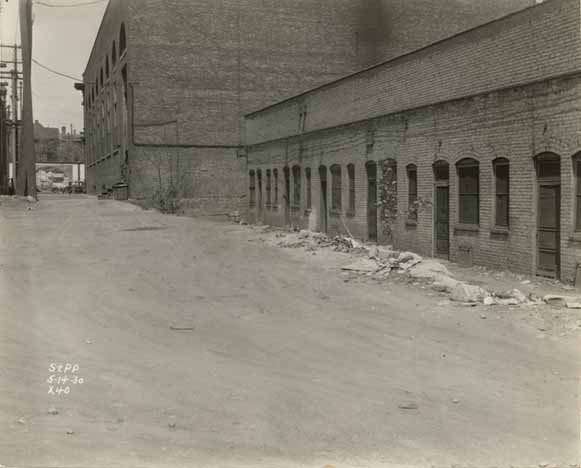
Exterior of Green Lantern, on right: 5-13-1931. Photo courtesy Minnesota Historical Society
“Then I got a little more interested and started looking for specific things to connect the Green Lantern with the photos,” Neuberger said. “I had always wanted it to be the Green Lantern, but how are you going to prove it? You’re not just going to take my word for it, and I wouldn’t, either.”
He pulled the case file on the Ventress homicide and combed through interview notes from the investigation. One witness described the bar as having three booths, which Neuberger’s photos clearly show.
Another pair of witnesses noted their favorite menu items: the spaghetti and the pork chop sandwich, respectively. Both can be found on the menu board above the bar in the photos.
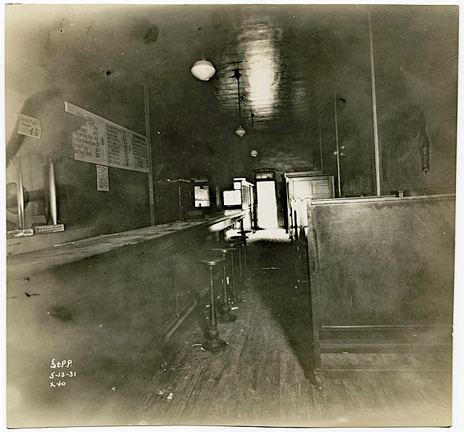
Green Lantern interior, 5-13-31. Photo courtesy MHS
Then there’s the fact that the photographer seemed to focus on the saloon’s back door, where the murder took place. Pioneer Press coverage of Quinn’s trial notes that witness Harry Kremer “identified police photographs of the interior and rear entrance of the cafe” for the jury.
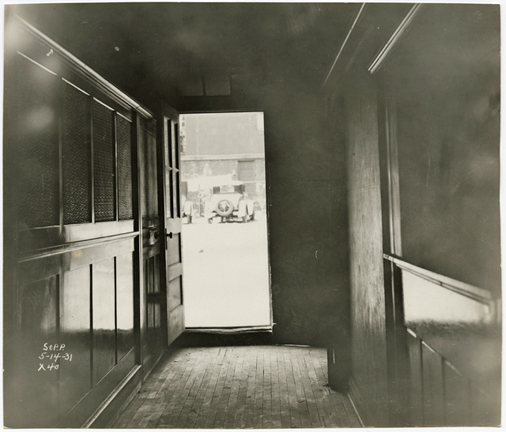
Back door of Green Lantern. Photo courtesy MHS
“Everything kind of fits,” Neuberger said. “There’s nothing to disprove it.”
They only wrinkle in Neuberger’s theory is that the exterior photo — the one he and Sazevich used to identify the building as the Green Lantern — is dated May 1930, rather than 1931. But because it shares the X-40 case number with the rest of the photos from the envelope, Neuberger believes this was a labeling error.
Asked to examine the photos, Maccabee said he found nothing that would undermine Neuberger’s conclusions. “From an authentication standpoint, there’s nothing that I’ve seen that would cast doubt on this,” he said.
Members of the public can now view the images for themselves and draw their own conclusions.
Dorothy Louise Ulmer was born on January 17, 1912. Less than three years before she was born, on May 13, 1909, her maternal grandfather Louis Arbogast, a St. Paul butcher, was found dead in his bed. He had been killed with an axe and set on fire. His wife Minna and daughter Louise were arrested and charged with his murder. Minna was acquitted on November 4, 1909, and charges against Louise were dropped on December 3, 1909. Allegations of incest may have swayed the verdict. Dorothy’s mother was Emma Arbogast, a younger daughter of Minna.
In 1931, 19-year-old Dorothy Ulmer married Frank Ventress, an unemployed cook, and the couple lived with her mother. Ventress hung around the fringes of Saint Paul’s criminal element. On March 19, 1931, Frank took his wife to the Green Lantern Saloon. They sat in the middle booth. If this was a date night, it was an inexpensive one as the couple had crackers and milk. While in the booth a man came up to Frank Ventress and asked to see him out the back. Frank told Dorothy he would be right back and walked to the back door. As he did he encountered John Quinn and Frank Fay entering the rear door. Ventress said to Quinn, “What are you doing here you son of a bitch!” The end result was that Ventress was shot in the chest and Quinn and Fay fled. Dorothy Ventress rushed to her husband and knelt beside him. She begged others to help him but Ventress coughed and died on the floor.
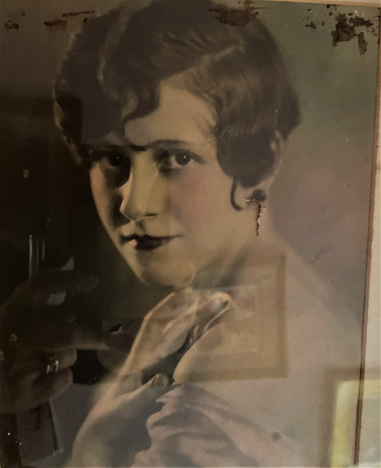
Dorothy Louise Ulmer courtesy of Wendy Minarek via Jeff Neuberger
Dorothy was now a widow. On August 4, 1939, she married Claire Lucas, another fringe criminal. The marriage did not last. Dorothy went back to using Ulmer as her last name and when she died in November 1979, she was buried in Oakland Cemetery in St. Paul by her parents. Frank Ventress is also buried there, as is Louis Arbogast.
But was there music? Who knows, but I’d like to think so!
The building was razed in the 1950s.
This page is about the Green Lantern Night Club that Ron Maddox owned in the 1970s. For the story of the original, notorious Green Lantern, click here.
GREEN LANTERN
In 1973, a report of St. Paul bars and restaurants included Ron Maddox’s Green Lantern, located
The club had a Roaring ’20s motif. Liquor was served in heavy mugs, as it was in speakeasies.
Maddox noted that gangsters in the 1920s tended to be vain in their appearance, and they spent a lot of time in barber chairs, so he put one in the club. Men could get shaves during the day. (Minneapolis Tribune, December 3, 1973)
The club lasted until at least 1976.
Green’s Nite Club (Green’s Place) opened on November 26, 1952, at Western and Como in St. Paul. Performing that night was “King” Larry Jazz Combo, “the Northwest’s most danceable unit.” It was only mentioned this one time in the Minneapolis Spokesman.
INVER GROVE NIGHT CLUB
The Inver Grove Night Club was just across the Railroad tracks on 66th Street, east of Concord in Inver Grove Heights.
In October 1945, Gerald Driscoll, 43, was arrested on a carnal knowledge charge after an “attractive 15-year-old girl” told of her ten days barhopping and staying in a St. Paul hotel. The episode started when she met him at the Inver Grove Night Club, and Driscoll was described as an operator of night clubs in South St. Paul and Inver Grove.
In February 1956, Frank M. Sazenski was the proprietor of the Grove Night Club. Sazenski was one of 40 caught in a sting of bars that had pinball machines for which the Federal tax had not been paid for gambling devices. Pinball was classified as a gambling device because of the poor odds of winning a “free game,” and termed even more insidious that slot machines, which had been outlawed in 1947. Sazenski plead guilty and paid a $500 fine.
KING OF DIAMONDS
In 1965, the Grove was expanded and made into a Gentlemen’s Club. Its address is 6600 River Road at Concord. Its owner, Larry Kladek, went to prison for tax evasion in 2009, but his wife Susan bought the business.
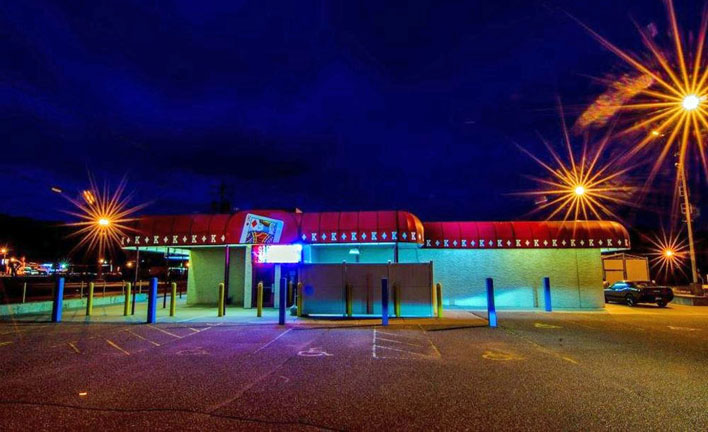
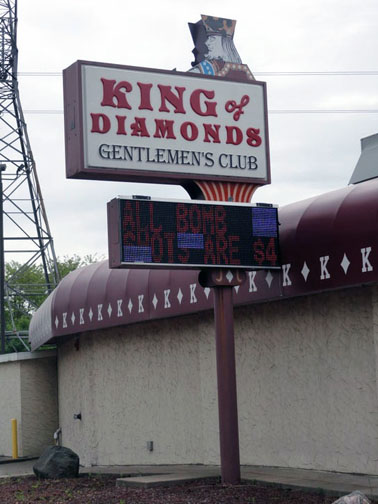
June 3, 2011 image from the Patch
Gulden’s Restaurant and Bar was located at 2999 Highway 61 in Maplewood.
Thanks to the fine folks on Facebook for bringing this venue to my attention!
Gulden’s was started in 1934 by the Gulden family. A news article said that the second owner was the Biggs family, but no years were noted.
The club went through several names.
GULDEN’S 19th HOLE TAVERN: 1952 – 1954
This seems to be the first name for the place, named for its location across the highway from the Keller Golf Course. It was a “bottle club,” where members brought their own spirits and had lockers to keep them there. The place had no liquor license.
CLUB SUBURBAN: 1958 – 1963
Donald V. Gulden was in the group receiving the first on-sale liquor licenses in the Village of Maplewood in June 1960. By this time it was in its Highway 61 location, perhaps three miles from the original 19th Hole. In October 1960 it was allowed to operate on Sundays. Don Gulden owned until at least 1963.
GULDEN’S PIED PIPER: 1966 – 1968
Gulden’s Pied Piper Restaurant shows up in May 1966. On July 22, 1968, the Pied Piper suffered $100,000 worth in fire damage to its one-story brick and stucco building.
GULDEN’S SUPPER CLUB: 1977 – 1984
Another fire hit the Gulden’s Supper Club on July 26, 1983, again causing $100,000 in damage. 50 Maplewood firefighters took four hours to put out the blaze, and the State Highway Patrol had to close Highway 61 during the morning rush hour to accommodate the fire apparatus.
Its third and final owners were Mike and Brenda Gengler, who bought it in 1990. (Doyle Biggs was a co-owner in 1993.)
GULDEN’S ROADHOUSE: 1990 – 2002
The Totally Bonkers Comedy Club rotated through the Roadhouse during 1991 – 1992.
1993: Karaoke Bar
GULDEN’S RESTAURANT: 2008 – 2016
GULDEN’S RESTAURANT AND BAR: 2015
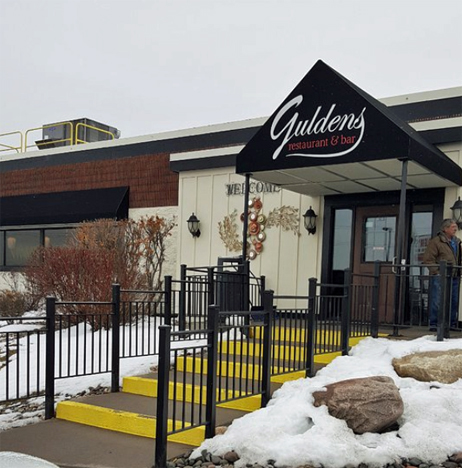
Mike Gengler died of cancer on March 8, 2018, and his wife Brenda ran it by herself for a while. The building was purchased by Toyota, and the restaurant closed on March 11, 2020, unrelated to the Covid shutdown.
THE WALKER ART CENTER
Although the concerts listed here were held at the Guthrie Theater, the vast majority of them were booked and sponsored by Walker Art Center. The Walker is a museum that actually started as a collection of items that lumber baron T.B. Walker kept in his mansion at 803 Hennepin Ave., now the site of the State Theater and the Walker office building. In 1926, Walker built a gallery to house his collection on the site of the present Walker Art Center. That building was demolished in 1969 and a new building replaced it in 1971. It was expanded and modernized in 2005. Ironically, instead of holding T.B. Walker’s collection, his museum became known for its collection of modern art.
THE WALKER CENTER ARTS COUNCIL
According to material in the Walker’s institutional records, the Center Arts Council (CAC) was a volunteer organization under the aegis of the Walker Art Center that organized performing arts for the Walker. It was active from 1954 to 1971. Staff coordinators were James Elliott, John Ludwig, and Jay Belolli.
SUMMER JAZZ SERIES
Before the Guthrie was built, the CAC sponsored various events, notably an outdoor jazz concert series featuring local cornetist and bandleader Paul W. (Doc) Evans. The concerts were held in a remodeled open-air court at the rear of the Walker, newly painted and equipped with a stage and canopy, lighting, and greenery. This series, always featuring Evans, began on June 30, 1953, and the first concert drew 700 people, according to Norman Houk of the Minneapolis Tribune, reporting the next day. In 1958, Herb Pilhofer and his modern jazz group took over a significant part of the schedule. In 1959, attendance for opening night was a record 1,250. The series continued through 1961.
In 1962 the Minneapolis Star and Tribune were on strike, but the Minneapolis Daily Herald reported that the Walker sponsored a program called “Jazz ’62-II,” on the south yard of the Walker Art Center.
Another interesting CAC event was called “A Happening in a Mushroom Cave,” featuring artist Allan Kaprow in the Wabasha Caves on November 17, 1962. Other notable events sponsored by the CAC were Bottlenecks I (1970) and II (1971), which were frolics in Loring Park with local bands, theater happenings, etc.
Between the Walker’s first concert at the new Guthrie Theater in May 1963 and John Ludwig’s appointment as the Coordinator for the Guthrie and the Walker in the spring of 1964, one would suppose that it was the CAC that technically booked the first year’s shows at the Guthrie.
JOHN LUDWIG
According to his biography in the Walker’s archive, John Ludwig (1935 – 1995) was appointed coordinator for the Guthrie Theater and the Walker Art Center in the spring of 1964. He was responsible for scheduling events in the Guthrie Theater when the theater company was not using the space. It was Ludwig, also continuing to rely strongly upon recommendations from the volunteers of the Center Arts Council, who began booking pop and rock performers in the late 1960s, such as Janis Joplin (August 1968), Blood, Sweat and Tears (January 1969), Led Zeppelin (May 1969), and the Who (June 1969). One CAC member, Suzanne Weil, was in particular a driving force behind the bookings of these concerts that also included dance events along with rock, jazz, folk, blues, and world music shows. In January of 1969, Ludwig began to devote most of his efforts to the Center Opera Company, which ended its association with the Walker Art Center that same year.
SUZANNE WEIL
Suzanne Weil was hired as a consultant during this transitional period to formalize her longstanding involvement in shaping the Walker’s concert program through her active role in the CAC. Ludwig left the Walker to become the full-time general manager of the Center Opera Company in July 1969. Weil was appointed full time Coordinator in July 1969 and greatly expanded the Walker’s performing arts program with the opening of the Walker’s Barnes building in 1971.
She was active on the Jazz Committee and became president of the CAC in 1969. In January 1969 she was hired as a consultant to assist the Performing Arts Coordinator Ludwig, as he prepared to leave.
It appears that Weil had a great deal of influence on the acts that were booked before she was officially appointed to the Coordinator’s position in July 1969. In an article by Robert T. Smith in the Minneapolis Tribune dated June 10, 1969, he has already identified her with that title and he wrote that she took the job six months ago. He said that she brought in Pete Seeger (March 22, 1969), Led Zeppelin (May 18, 1969), and Blood, Sweat and Tears (January 16, 1969).
Weil’s biography in the Walker archives reads, in part:
Under Weil’s leadership, the Performing Arts department presented dance, music, poetry, theater events and residencies. The program framework that Weil developed continues to shape the Performing Arts at the Walker Art Center.
Weil also became known as a rock promoter after she began scheduling rock concerts on Sunday evenings at the Guthrie Theater. Weil booked legendary rock musicians at the start of their careers. Among the artists she brought to the Twin Cities were Elton John, the Grateful Dead, the Mothers of Invention and Patti Smith. The concerts served to fill many gaps. Bands on a tour general traveled Sundays without stopping for a performance. The Guthrie Theater was dark on Sunday nights. Weil connected the dots and booked acts on Sunday nights, thus providing the area with a popular series of Sunday night concerts. The concerts also provided much-needed revenue to present poets, choreographers, and avant-garde musicians; the core of the Walker’s performing arts program.
Weil had a personal and easy style with the artists she presented, as reflected in her correspondence. She made sure she knew what the artists required for their visits, as well as their preferences for things as food, housing, and transportation. Often artists would stay at her house and her hospitality became legendary.
Case in point: in his column in the Tribune dated June 10, 1969, Robert T. Smith reported that when Pete Seeger came to town, she met him at the airport, drove him to his hotel, and then went home and baked him some some bread. “What do you do for Pete Seeger?” she said. “He makes you want to bake bread.”
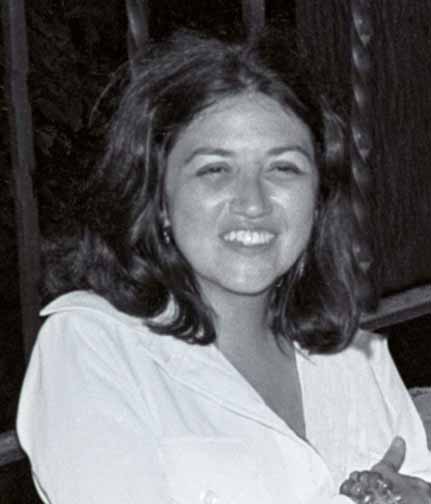
Photo of Suzanne Weil copyright Mike Barich
**It should be pointed out that rock acts had been booked at the Guthrie as early as November 1967 with the Butterfield Blues Band, and would have been earlier if the Blues Project hadn’t cancelled in July 1967. Janis Joplin had appeared in August 1968. Also, the text above might be a little misleading, in that the Grateful Dead and the Mothers of Invention had been to the Twin Cities several times before their Guthrie appearances.
An article called “The New Rock Concert Promoter” in the September 1972 Insider says this about Mrs. Weil:
Her Guthrie concerts are part of the Walker Art Center’s commitment to displaying contemporary art forms. The concerts consistently lose money because she usually brings in acts before they break nationally. Weil picks acts on instinct and on advice of friends, other artists, and anyone else who offers it. Her only criterion is that the artists be developmental or experimental…While Weil has capital to work with, she is only interested in breaking even and exposing the talent.
[The assertion above that none of the concerts made money is not necessarily true. Many Guthrie shows made money that Weil could then use to pay for dance and other events that needed subsidy in the pre-grant era.]
In October 1976, Weil accepted a new position at the National Endowment of the Arts in Washington, CD, as the Director of Dance Programming. Nigel Redden became the Walker Art Center’s Performing Arts Coordinator in November 1976. Weil subsequently served as senior VP of programming at PBS (1982-1989) and executive director of the Sundance Institute.
SUE MCLEAN
With Sue Weil’s departure from the Walker, the Guthrie cemented its interest in controlling the booking of music concerts in-house, eventually hiring Sue McLean as its concert booker, first as a Guthrie staff member, then continuing when she went independent and forming her own agency that had great impact in the Twin Cities music scene. The Walker did continue to occasionally book a few notable concerts at the Guthrie in subsequent years, such as the opening concert of the New Music America Festival in 1980 which featured a triple bill of David Byrne with a string ensemble, Philip Glass and the art ensemble of Chicago, or later concerts with Ornette Coleman’s Prime Time Band.
The Guthrie Theater opened on May 7, 1963. Its first production was Hamlet, directed by the theater’s founder, Sir Tyrone Guthrie. Guthrie and friends Oliver Rea and Peter Zeisler had been disenchanted with Broadway, and wanted to create a theater with a repertory company that would present the classics. The repertory company included George Grizzard, Hume Cronin and Jessica Tandy. The group advertised in the New York Times, soliciting cities that would be interested in sponsoring such a theater. Of the seven cities that responded, the founders were impressed with the demographics but mostly the enthusiasm of the Twin Cities for the project.
The theater was built on donated land behind the Walker Art Center. It was planned by architect Ralph Rapson and completed in 1963. Its 1,441-seat thrust stage was designed by Tanya Moiseiwitsch, with a seven-sided asymetrical platform measuring approximately 32 by 35 feet, raised three steps above floor level.
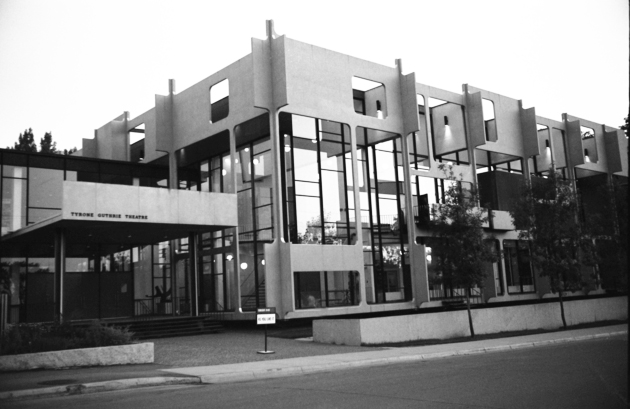
1966 photo of the Guthrie Theater by Terry Garvey courtesy Minnesota Historical Society
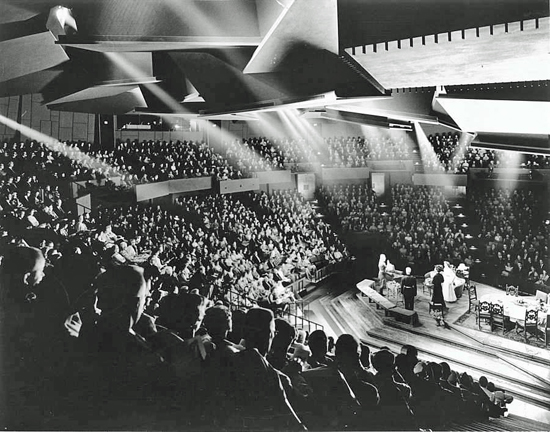
Inside the original Guthrie
Michael Bjornberg remembers that
there was a small bar accessed from the seating area that was typically not monitored by security (in those days) – I think it was the “dram bar” perhaps. It would be possible to slip back after shows and mingle with bands.
CONCERTS AT THE GUTHRIE
The Guthrie was not built as a concert venue – it was built to present plays. There were no pillows on the floor, no drinking, no smoking, no dancing, and it was not an interactive experience like the Labor Temple and the Depot had been. Ticket prices were higher, too. But it was a way to fill the seats during the off season, and present visually and acoustically perfect music to 1,437 lucky ticket holders. At first, the Guthrie was used to continue the Walker’s Summer Jazz Series.
Below is a listing of mostly national musical acts that have been presented at the Guthrie, probably 99 percent of which were presented by the Walker Art Center. There are some exceptions here and there, including comedians and local icons such as Koerner, Ray, and Glover. Some performances that were held in the Walker Auditorium are also listed, either because there are photos, or because they include people like Patti Smith or Allan Ginsberg. My sources are listed at the end.
1963
MODERN JAZZ QUARTET
The first musical performance in the new venue was held on May 27, 1963, by the Modern Jazz Quartet. It was billed as part of the Walker Art Center’s 10th Annual Summer Jazz series, given that the original series started in 1953 (see above).
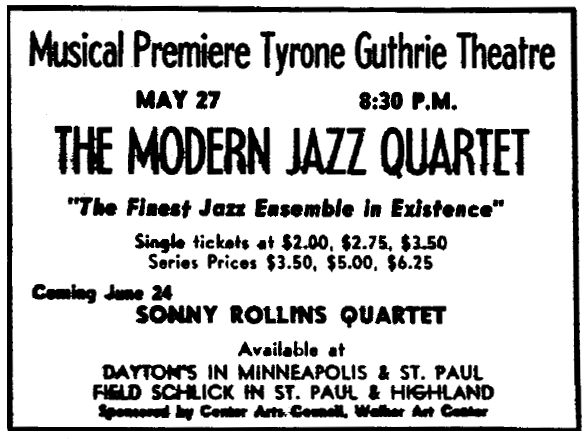
Ad from Minnesota Daily, courtesy Robb Henry
The Modern Jazz Quartet started in 1951 as four members of Dizzy Gillespie’s band, strictly to give Gillespie a break during performances. The members performing in 1963 were leader John Lewis on piano, Milt Jackson on vibraharp, Percy Heath on bass, and Connie Kay on drums. They wore formal cutaway coats on stage, and leader Lewis had two degrees at the Manhattan School of Music.
SONNY ROLLINS
Sonny Rollins and his Trio played to a sold-out crowd on June 24, 1963. The performance was also part of the Walker’s 10th Annual Summer Jazz series.
Dan Sullivan of the Tribune called the music “angry, perverse, often fascinating and ultimately exhausting.” Sullivan didn’t like it, but he said that “you cannot deny that their music is a frighteningly accurate picture of an age unsure of anything but the force of its will to destruction.” Sonny Rollins’ saxophone was “voiced in burps, squeals, shrieks, strangled gasps and just plain clinkers.”
Rollins’ Trio featured Paul Bley on piano, Roy McCurdy on drums, and Henry Grimes on bass.
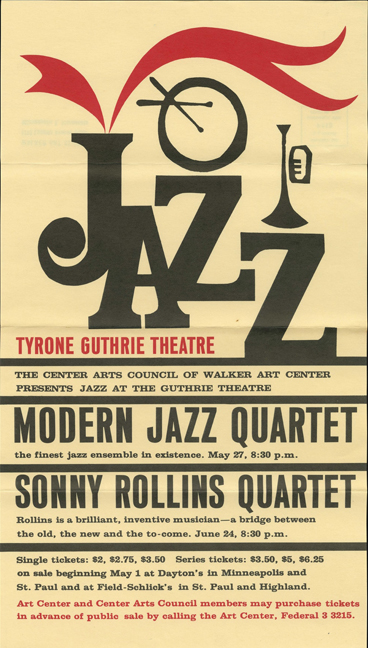
Poster for the Walker’s Jazz at the Guthrie series, 1963. Source unknown
PRESERVATION HALL JAZZ BAND
Kid Thomas and His Algiers Stompers came to the Guthrie to play – not Dixieland, but New Orleans jazz on July 22, 1963.
It was a large band, featuring George Lewis – the Tribune’s Allan Holbert described him as one of the greatest clarinetists of this century. The band was playing at several places around town during the week. Apparently this was not part of the Jazz at the Guthrie concerts.
1964
The Walker’s Center Arts Council sponsored a series of American Folk concerts in early 1964:
Mountain String Band and Banjo Songs, January 25, 1964: About 1,100 people, “very few in dungarees,” came to hear American mountain music.
- New Lost City Ramblers of NYC: Mike Seeger, John Cohen, and Tracy Schwartz. Dan Sullivan of the Tribune called them “smart enough to have smoothed mountain music into a profitable commodity and wise enough not to have perverted it. They are synthetic but not pseudo.”
- Roscoe Holcomb of Daisy, Kentucky: Dan Sullivan deemed them to be the “genuine article – two modest, simple men who remember all the old songs nobody ever bothered to write down.”
- Dock Boggs of Norton, Virginia
Sullivan congratulated John Pankake, co-editor of the Little Sandy Review for insisting on the real thing for this concert.
American Negro Folk Songs and Blues, February 8, 1964:
Bessie Jones and the Sea Island Singers of St. Simon’s Island, Georgia. Program notes consisted of a lesson in the Georgia Sea Islands, and a short biography of Bessie Jones, written by Alan Lomax himself.
Mississippi John Hurt, Avalon Mississippi. Program notes provided a biography of Hurt, written by Dick Spottswood of Arlington, Virginia. Will Jones reported that Hurt, 72, was rediscovered about a year prior by record collector Tom Hoskins from Washington, DC. Most collectors of his 1928 records had assumed he was dead. Hoskins found Hurt at home in Mississippi and told him he was going to take him to Washington to record. Hurt was convinced that the record buff was really from the FBI: “I knew I hadn’t done anything sinful, but I went along anyway. Now I’m sorry the FBI man didn’t discover me a few years earlier.” (Minneapolis Tribune, January 24, 1964)
Sleepy John Estes, Lowry County, Tennessee with Hammie Nixon and Yank Rachel. Bob Koester’s program notes indicated that Estes had gone missing for many decades, and most afficionados of his music assumed that he was much older than he was. But when he was rediscovered in 1950, he was only 60 years old, and his career was restarted.
This concert (above) included a folk music workshop at 1 pm.
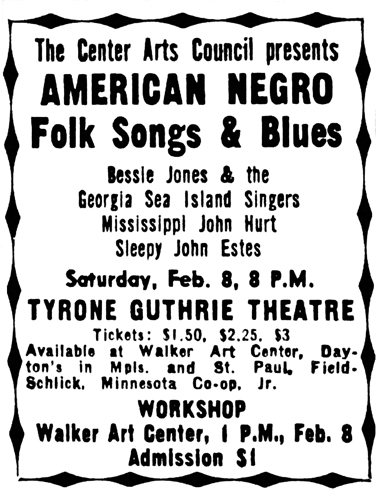
Minneapolis Star, February 1964
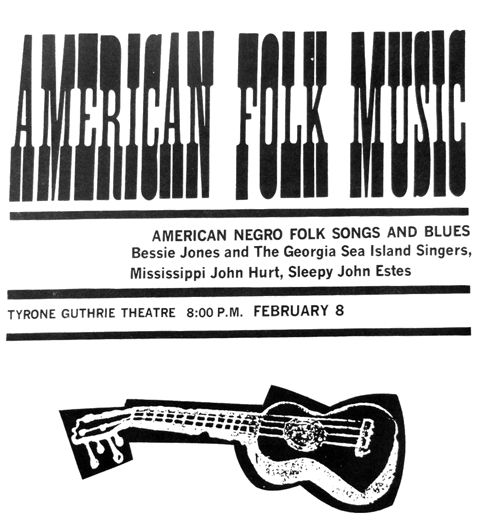
Program image courtesy Grant Johnson
Traditional Ballads and Folk Songs, February 22, 1964:
- Jean Ritchie of Viper, Kentucky
- Doc Watson of Deep Gap, North Carolina with Fred Price and Clint Howard of Mountain City, Tennessee
THEODORE BIKEL
Folk singer Theodore Bikel made his first Twin Cities appearance on February 23, 1964, at the Guthrie, presented by the Minneapolis Chapter of the Hadassah.
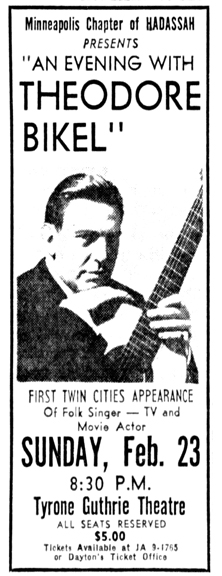
Minneapolis Tribune, February 1964
JOHN CAGE
The Merce Cunningham Dance Company appeared on February 25, 1964, accompanied by the music of John Cage and David Tudor – a Walker Center Arts Council concert.
Dan Sullivan of the Tribune called Cage and Tudor’s music a “medley of squeaks, squeals, yowls, yammers, explosions, and general clatter.”
JAZZ AT THE GUTHRIE ’64
The Walker Art Center presented a series of four Sunday evening jazz concerts at the Guthrie starring four of the greatest jazz performers of the era. The series was called the Walker Center Arts Council summer Jazz series. Incredibly, tickets for these concerts were $2.50, $3.50, $4.00, and $1.75 for students.

Minneapolis Tribune, June 1964
The Thelonious Monk Quartet appeared on June 14, 1964. An article (presumably from the Minnesota Daily) said:
Monk’s compositions and innovations in rhythm and harmony have provided major inspiration to modern jazz musicians. He has played a major role in the birth of be-bop and the avant-garde movement in modern jazz.
Dan Sullivan of the Tribune complained about the short concert of only 75 minutes. Monk played piano and his sidemen were Ben Riley on drums, Gene Taylor on bass, and Charles Rouse on tenor sax.
The Coleman Hawkins Quartet appeared on July 19, 1964. With him were Eddie Locke on drums, Paul Neves on Piano, and Major (Mule) Holly on bass. Hawkins played played tenor saxophone.
The Dizzy Gillespie Quintet appeared on August 19, 1964, before a capacity crowd. He and his band played for 2 1/2 hours. In his Quintet were James Moody, on Flute, tenor and alto saxes; Christopher White on bass; Kenny Baron Piano, and Rudy Collins on drums.
The Gerry Mulligan Quartet, with Dave Bailey, Bob Brookmeyer, and Bill Crow, appeared on September 27, 1964.
The Preservation Hall Jazz Band with Sweet Emma Barrett and Her Boys performed on October 18, 1964. Sweet Emma was the “belle gal,” dressed in a flaming red suit and beany to match. Around her right calf was her trademark band of bells. She danced and (this is unclear) played banjo while seated in a straight backed chair. Sidemen included Percy Humprey, Emanuel Sayles, Alcide Pavageau, Jim Robinson, Josiah Frazier, and Willie Humphrey, Jr. This was a bonus Jazz concert for summer Jazz at the Guthrie subscribers. The album “Sweet Emma and Her Preservation Hall Jazz Band” was recorded at this session. Presented by the Walker in association with Jass Inc.
1965
GEULA GILL
Geula Gill & Company brought her show to the Guthrie on February 27, 1965, presented by the Minneapolis Chapter of Hadassah. Ms. Gill was an Israeli singer and actress, and had appeared on the Ed Sullivan Show in 1948. She could sing in a few languages and several octaves. She was accompanied by a bass player and two guitar players, who sometimes sang with her.
Allan Holbert of the Tribune said that she and her group were so appreciative to Peter, Paul, and Mary for the song “If I Had a Hammer” that they thought about changing their name to “Abraham, Isaac and Sarah.”
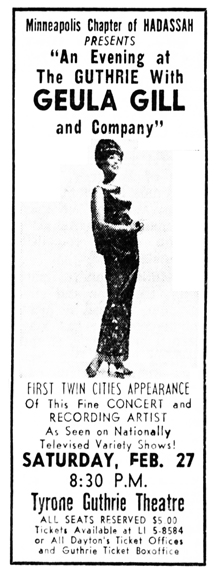
Minneapolis Tribune
AMERICAN FOLK MUSIC SERIES
The Walker Center Arts Council presented three Saturdays of Folk music in the Spring of 1965.
Folksingers Almeda Riddle, Mainer’s Mountaineers, and Kirk McGee appeared on March 6, 1965.
Folksingers the Lilly Brothers and Clarence Ashley appeared on March 20, 1965.

Minneapolis Tribune, February 1965
Reverend Gary Davis, Elizabeth Cotten, and Jesse Fuller performed on April 3, 1965.
DUKE ELLINGTON
Duke Ellington and His Orchestra, , performed on March 23, 1965, to a sellout crowd, presented by the Walker Center Arts Council.
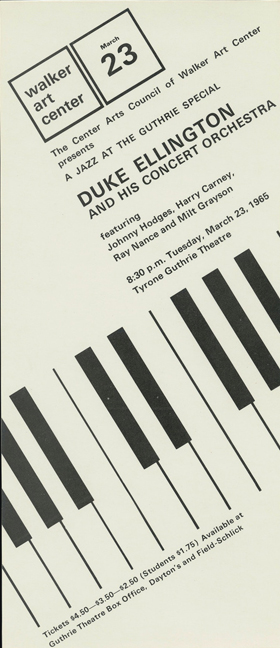
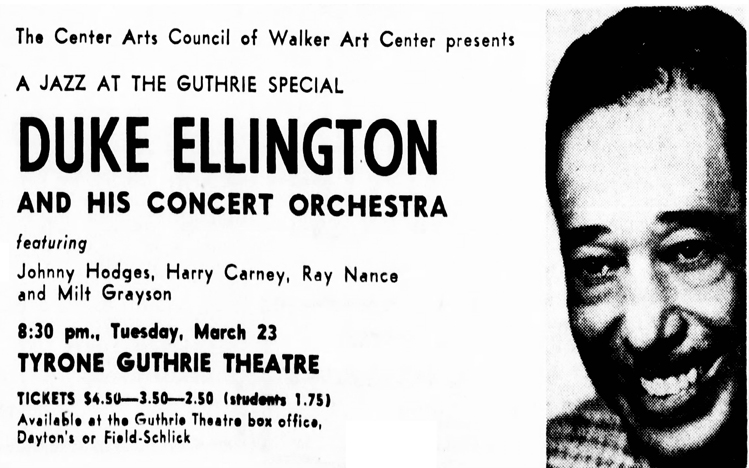
Minneapolis Tribune, March 1965
Don Morrison, Star columnist, reflected that he had seen a Duke Ellington show 19 years ago and it was still the same, and still excellent. Some of the old stars in the band were still alive; Cat Anderson, Paul Gonsalves, Sam Woodyard, Harry Carney, Lawrence Brown, Johnny Hodges, Cootie Williams, Ray Nance, Milt Grayson, and Mercer Ellington.
JAZZ AT THE GUTHRIE ’65
The Walker Art Center again presented a series of four jazz concerts at the Guthrie starring four of the greatest jazz performers of the era. The series was called the Walker Center Arts Council summer Jazz series.
CHARLES MINGUS
The Charles Mingus Quintet, performed on May 30, 1965. The audience was not sold out, numbering about 1,200.
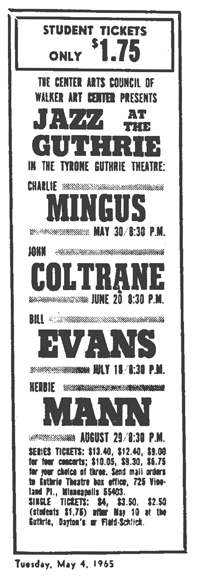
Ad from Minnesota Daily, courtesy Robb Henry
Allan Holbert of the Tribune found the concert for the most part “stimulating, fresh and skillfully presented.” Sidemen were Dannie Richmond on drums, Charles McPherson on alto sax, Lonnie Hillyer on trumpet, and Jaki Byard on piano. Mingus played bass.
Charles Helm:
I stumbled upon info that this Mingus concert, sponsored by the Walker at the Guthrie, was recorded and issued on albums twice. The Guthrie concert was first issued on the Mingus album “My Favorite Quintet” (Fantasy label, 1965) https://www.discogs.com/release/2072924-Charles-Mingus-My-Favorite-Quintet
Then in 1980 it was reissued as one album of the double album set “Portrait” by Charles Mingus on the Prestige label (the other album in this package was a 1964 live show from Town Hall in NYC).
https://www.discogs.com/release/2429223-Charles-Mingus-With-Eric-Dolphy-And-Jaki-Byard-Portrait
For the release of the 1980 Portrait double album the great jazz pianist Jaki Byard, who played with Mingus for both concerts, wrote liner notes. Below is an excerpt of Jaki’s liner notes for Portrait where he describes the generous treatment and reception for the Guthrie show and his encounter with a local woman who was a CAC member (Mingus was infamous for being cantankerous and rude) plus some details on “My Favorite Quintet” and “Portrait.” Cool that this concert was recorded and issued twice on albums and it included this insider info on WAC’s Center Arts Council in action hosting concerts. Mingus’ band at this concert is well deserving of the album’s title My Favorite Quintet.
EXCERPTS FROM JAKI BYARD’S LINER NOTES on the 1965 gig at the Guthrie Theatre in Minneapolis
“……Before the concert, red carpet treatment was in full bloom: limousine service from the airport, cocktails and hors d’oeuves, seminar, then dinner. I noticed this charming older women, all agog over Mingus, just a-chatting away. Finally, she came over to me and right away I asked her: “What the hell is it that you find so intriguing about Mr. Mingus?” She said, “I adore his impudence, he has such enthralling surliness, like an English lord, ya know!” I said, “Uh-huh” (and half understood what she meant). But her statement really helped to turn me on to the behavior of the late Charles Mingus, and I think after that I was more tolerant than ever before of his weird ways.”
“My entire association with Charles Mingus was an honor and a treat — including all the moods, temperaments, personality clashes, cooperation, and feelings of accomplishment and self-gratification. I can’t find any superlatives strong enough to define what those years meant to me. I left Mingus in 1968 primarily because of domestic obligations, and also because I felt an urge to pursue in my own ways some obligatory missionary work in the growing jazz community. But I continued to appear with him, off and on, until 1976.
Jazz, in my language, is a four letter word spelled L-O-V-E. Charles Mingus was one of the people who taught me to spell.”
— Jaki Byard
JOHN COLTRANE
The John Coltrane Quartet performed on June 20, 1965. It was a capacity audience.
Allan Holbert of the Tribune reported that two of his usual sidemen, pianist McCoy Tyner, and bass player James Garrison, had missed a plane somewhere, so local musicians Dub Frazier took over on piano and Maurice Turner filled in on bass. Elvin Jones was there as his regular drummer, and Coltrane played the sax. After the first tune after intermission, Garrison and Tyner finally arrived, and Holbert called it a “striking improvement in the caliber of the ensemble work.”
HERBIE MANN
Herbie Mann performed on August 29, 1965 with his octet.
Mann was described as “the bossa nova pioneer,” and an article said that he had created a new “ethnic jazz” by combining African and Latin American rhythms with American jazz. His sidemen were:
- Dave Pike, vibraharp
- Jack Hitchcock, trombone
- Mark Weinstein, trombone
- Jane Getz, piano
- Earl May, bass
- Bruno Carr, drums
- Carols Valdes, conga drums
BILL EVANS
The Bill Evans Trio performed on September 19, 1965, as part of the Walker Center Arts Council’s “Jazz at the Guthrie” series. The audience numbered about 1,100.
Evans was originally scheduled to perform on July 18, but illness forced a postponement to a later date. Evans’ sidemen were Chuck Israels on bass and Arnie Wise on drums. Evans played piano.
Allan Holbert from the Tribune wrote that a lot of local bass players were at the show to see Israels, calling him “tasteful and articulate.”
ODETTA
Odetta performed at the Guthrie on November 14, 1965, presented by the Walker. This was Odetta’s first appearance in Minneapolis. The concert was sold out.
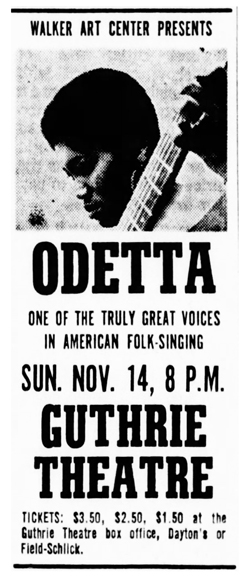
Minneapolis Tribune
Critic James Fuller of the St. Louis Park Dispatch gave this review on November 18, 1965:
Odetta… is the only woman folk singer around who could get away with doing the kind and variety of songs she does. Her contralto is recognized as one of the great contemporary voices in folk singing.
The opened the program with some cliches of the folk song business – tunes like “If I Had a Hammer” – and with her warm, honest approach made them sound new. By the middle of the the second half of the program, the crowd was clapping with her on the chain gang songs, and on her third encore, the one “freedom” song she sang all night, the audience joined in the singing and clapping without an invitation.
As reported above, Allan Holbert of the Tribune reported that she started with some overworked folk songs, followed by some more obscure material. She stayed away from the contemporary protest songs, although she did announce that the next number dealt with a racially mixed marriage. Then she launched into “Froggy Went a-Courtin'” She was backed by Leslie Brinage on bass and Bruce Langhorn on tenor guitar.
1966
The Walker Art Center ran two concurrent series of musical shows in 1966 – one was the “Jazz at the Guthrie” series, and the other was the “Folk Music at the Guthrie” series. Both genres were quite popular at the time, and the Walker brought in the best of the jazzmen and the most authentic folk music purveyors.
The Modern Jazz Quartet performed on January 21, 1966, as a special Walker Center Arts Council’s “Jazz at the Guthrie” concert.
BILL MONROE AND MANCE LIPSCOMB
Bill Monroe and the Blue Grass Boys, with Mance Lipscomb, performed on March 5, 1966, as a part of a Folk Music at the Guthrie series.
Monroe was accompanied by guitar, banjo, bass, fiddle, and Monroe’s mandolin. Maury Bernstein acted as m.c. and told the crowd that the performs would conduct a folk music workshop on March 6, 1966, at the Walker.
Allan Holbert at the Tribune reported that while Lipscomb was a bit hard to understand, he was indeed the real thing.
Tom Scanlan at the Star mused at how many genres Lipscomb sang, and the influence of American “rural Negro music” on music today.
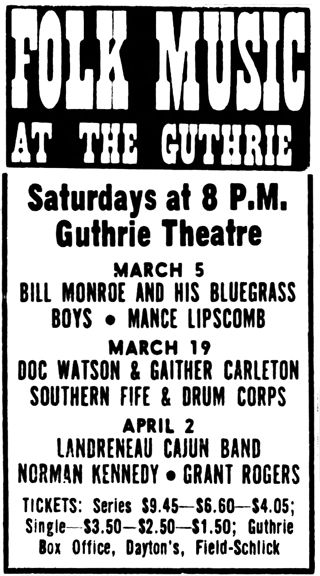
Minneapolis Star, March 1966
The American Jazz Ensemble performed on March 18, 1966, as a Walker Center Arts Council’s “Jazz at the Guthrie” late-night special.
DOC WATSON
Doc Watson, Gaither Carleton, and the Southern Fife and Drum Corps performed on March 19, 1966, as a part of a Folk Music at the Guthrie series. Watson also appeared with his son Merle. He played the guitar, banjo, harmonica, and 12-string guitar.
Tom Scanlan of the Star wrote:
On the same day (March 19, 1966) of Doc Watson’s concert, was a performance of the Southern Fife and Drum Corps. This group was made up of Ed Young, Lonnie Young, and G.D. Young from Como, Mississippi. Despite their name, they didn’t play military music, but “a strange, African-sounding blend of complex rhythms and haunting melody.”
But the high shrill, can fife of Ed Young floating over the driving polyrhythms of the bass and snare drums created a memorable experience. The visual content was almost equal to the musical, with half handing of the player an inseparable part of the artistry. Their music, a remnant of slave culture popular as late as the last decade in rural Southern areas, was difficult and wearing, but for all that, hypnotically powerful.
SERENDIPITY SINGERS
The Serendipity Singers appeared on March 20, 1966, presented by the Minneapolis Chapter of Hadassah.
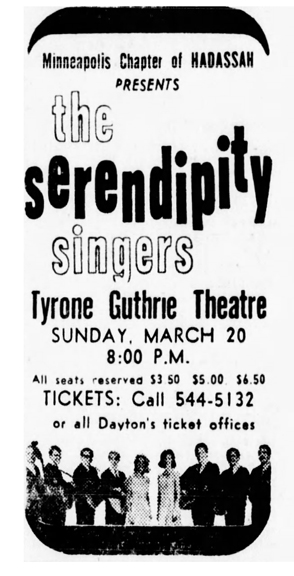
Minneapolis Tribune
The Landreneau Cajun Band, Norman Kennedy, and Grant Rogers performed on April 2, 1966, as a part of a Folk Music at the Guthrie series.
- Grant Rogers, from Walton, New York, sang and played in a “Northeastern” American genre
- Norman Kennedy was from Aberdeen, Scotland and sang Scotch and Gaelic songs of his country
- Adam and Cyrien Landreneau were from Mamou, Louisiana, and they sang in French.
CHARLIE BYRD
Jazz guitarist Charlie Byrd performed two concertos with the Minneapolis Symphony on April 17, 1966, presented by the Minneapolis Symphony and the Walker.
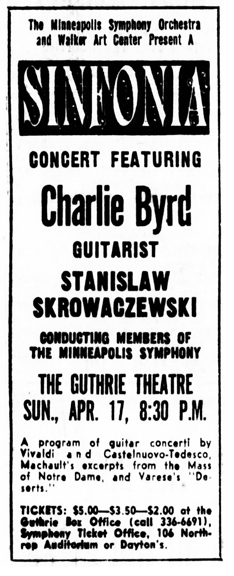
Minneapolis Tribune
Allan Holbert of the Tribune found his performance to be a disappointment. Holbert is rough, calling the first of the two concertos “an artistic failure,” saying “he forgot notes, he missed notes, he produced a tone that is beneath his capabilities.” The second concerto was better, wrote Holbert.
ELLA FITZGERALD
Ella Fitzgerald performed two shows on April 21 and 22, 1966, part of the Walker’s “Jazz at the Guthrie” series. Both shows were sold out. This may have been the first time that two shows were scheduled at the Guthrie.
The normally reticent Minnesota audience clapped appreciably before and after each song. She came with a trio headed by pianist Jimmy Jones.
Clark Terry and the Bob Brookmeyer Quartet performed on May 22, 1966, part of the Walker’s “Jazz at the Guthrie” series.
CHARLES LLOYD QUARTET
The Charles Lloyd Quartet performed on May 22, 1966, part of the Walker’s “Jazz at the Guthrie” series.
Lloyd’s sidemen included Keith Jarrett on piano, Cecil McBee on bass, and Jack Jonette on drums. Lloyd played tenor sax and flute.
Where magazine’s promo said that “Lloyd, along with John Coltrane and Ornette Coleman, is considered one of the foremost men of contemporary jazz. He infuses the tenor saxophone and flute with a new sound that promises to be the epitome of the New Wave in jazz.” (April 6, 1968)
The headline of Peter Altman’s review in the Star was “Charles Lloyd Quartet Concert is Quite Bizarre.” Peter goes on to call it “incredible, frenzied” and said that at least “at least 100 persons huffed out in indignant and conspicuous protest.” He talks about weird harmonies and unpredictable sifts of tempo. He writes that “the quartet is not an ensemble, it is a conflict. Its members have imagination, strength, and force. If you can stand it.”
Similarly, Allan Holbert at the Tribune called the performance a “puzzlement.” Sometimes the jazz was cool, spontaneous and exciting. At other times it was loud and monotonous, almost if the players were putting us on.”
OSCAR PETERSON
The Oscar Peterson Trio performed on July 24, 1966, part of the Walker’s “Jazz at the Guthrie” series.
The Trio had been hit recently by retirements, so the personnel had been changed Bassist Sam Jones had replaced Ray Brown. Drummer Louis Hayes had replaced Ed Thigpen
MIRIAM MAKEBA
South African singer Miriam Makeba performed to a near-capacity crowd on September 12, 1966, presented by the Walker.
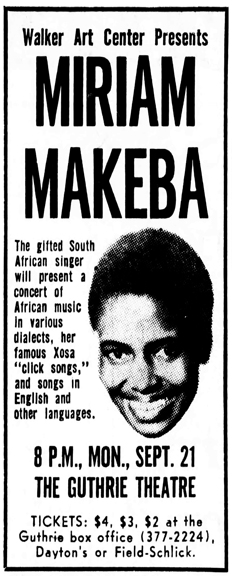
Minneapolis Tribune, August 1966
Reviewer Thomas Scanlan of the Star wrote that Makeba “dazzled everyone within hearing. Singing a repertoire that alternated among her own African music, Brazilian jazz and a variety of songs in English, Miss Makeba seemed to please an enthusiastic audience with everything she tried.” She could sing in three or four languages, and she received a standing ovation.
Jim Fuller of the St. Louis Park Dispatch noted that she was backed by a trio whose names were not in the program, and she had trouble with feedback from the sound system.
AHMAD JAMAL
Ahmad Jamal performed on October 16, 1966, presented by the Walker. It was a capacity audience.
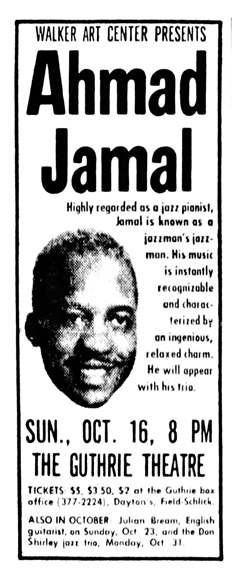
Minneapolis Star
Although the audience was very appreciative of Jamal’s work on the piano, Peter Altman’s review in the Star is headlined “Ahmad Jamal Trio is Short on Soul.” Jamal’s sidemen were Jamil S. Nasser on bass and Frank Gant on Percussion.
DON SHIRLEY TRIO
The Don Shirley Trio performed on October 31, 1966, presented by the Walker.
Lew Reeve in the Star reported that Shirley had an interest in playing the diverse musical forms of Americana. During the show the trio played a show tune, Protestant hymn, Negro spiritual, military march, and a Scarlatti Sonata. Members of the trio were cellist Juri Taht and Kenneth Fricker. Mr. Shirley played the piano.
1967
ORNETTE COLEMAN
The Ornette Coleman Trio, performed on April 30, 1967, part of the Walker’s “Jazz at the Guthrie” series. The event attracted half a house.
The rest of the trio was David Izenzon on bass and Charlie Moffett on drums. Coleman played the also sax, the musettte, the violin and the trumpet.
Reviewer Allan Holbert of the Tribune wrote that some of the pieces were avant garde, and some were more accessible, traditional, which got more applause
FOUR FRESHMEN
The Four Freshmen, billed as Jazz Vocalists, appeared on May 7, 1967.
The Four Freshmen were Ross Barbour, Ken Albers, Bill Comstock, and Bob Flanigan. The Show was sponsored by the Minneapolis Jaycees’ Arts and Culture Committee.
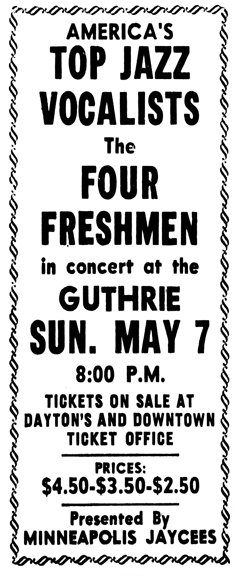
Minneapolis Star, May 1967
CANNONBALL ADDERLY
The Cannonball Adderley Quintet, with Nat Adderley, performed on May 21, 1967, part of the Walker’s “Jazz at the Guthrie” series.
THEODORE BIKEL
Theodore Bikel appeared on June 11, 1967, sponsored by Friends of Torah Academy.
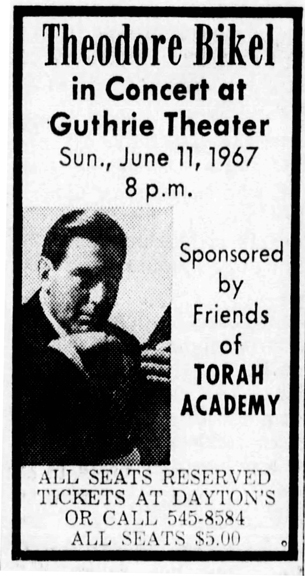
Minneapolis Tribune, June 1967
NINA SIMONE
Nina Simone performed on June 18, 1967, part of the Walker’s “Jazz at the Guthrie” series.
Allan Holbert’s review in the Tribune spent half its space focusing on Ms. Simone’s outfit:
She was dressed in a sleeveless, formal pants-suit made of what looked like white basketball net. It was lined, incidentally, with a silky fabric which, in color, could not be distinguished from her skin. Add to this gold-colored, high-heeled slippers, while, tassled armbands and earrings jangling and swinging three inches from her ears and you have my nomination for wildest-looking soloist in the next Downbeat poll.
The photo below is screen grab from a TV performance on YouTube, and it might be the same outfit:
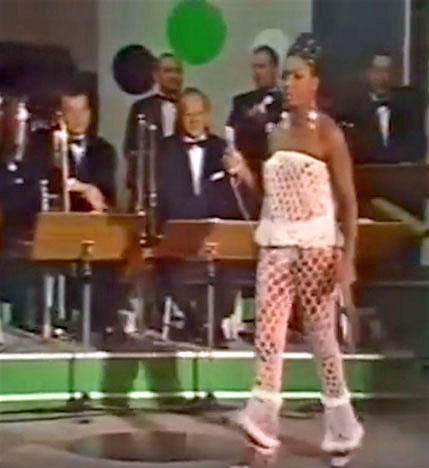
As for her performance, Nina was backed up by her own trio of guitar, bass, and drums players. Holbert wrote,
Hers is an unusually straight-toned voice that penetrates like a not needle. It weeps on the sad songs and crackles with fury on the mad songs. … She does about everything – pop, protest, blues, gospel, folk.
BLUES PROJECT – CANCELLED
The Walker scheduled a concert by The Blues Project at the Guthrie on July 9, 1967. The show was cancelled 48 hours before it was to go on, ostensibly because of the illness of lead singer Danny Kalb. This was just after Monterey Pop, and the band was losing its members, according to Wikipedia.
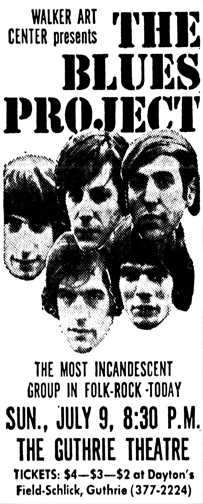
Minneapolis Tribune, July 1967
Because of the short notice, tickets had been sold and programs printed. The program below was found in the file at the Walker Archives.
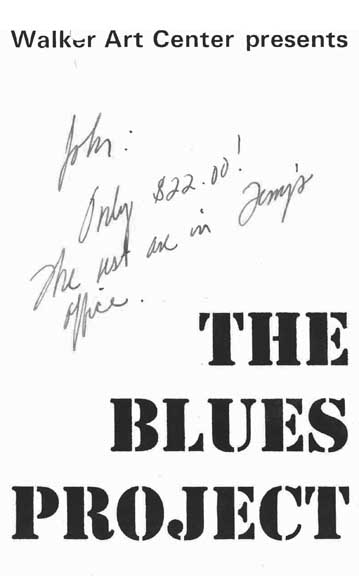
Image of Program courtesy Walker Art Center Archives, Performing Arts, Coordinator John Ludwig, Box 5 F8
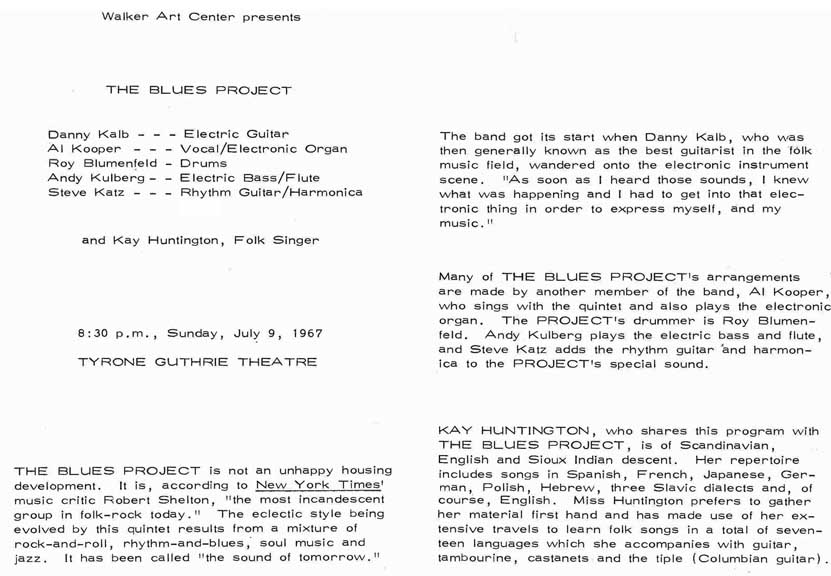
Image of Program courtesy Walker Art Center Archives, Performing Arts, Coordinator John Ludwig, Box 5 F8
The file reveals that the opening act was to be a local folksinger named Kay Huntington, who was to play for 15 minutes, and the the Blues Project was to play for 37 minutes. The show was described as being divided into two halves – the two acts would trade off, but it doesn’t sound like it was intended to be two shows.
John Ludwig, the program director at the Walker who had negotiated the contract, was hopping mad at what he called the “arbitrary” cancellation, and in a letter to the group’s agent at William Morris in New York, seemed to be calling for proof of Kalb’s illness. The Walker was out $450 in printing costs, and he threatened to pass those costs on to the group. Apparently that was a lot of money to lose in the Walker’s tight budget, and Ludwig was rethinking his decision to book rock groups again.
If this had gone on, this could have been the first rock act (“New York Folk Rock”) at the Guthrie.
HORACE SILVER
The Horace Silver Quintet performed on July 30, 1967, part of the Walker’s “Jazz at the Guthrie” series.
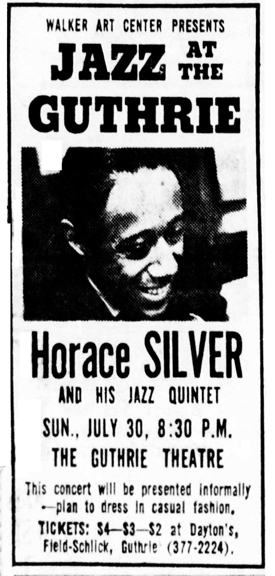
Minneapolis Star, July 1967
Allan Holbert of the Tribune deemed Silver’s music to be pleasant and highly listenable – a little old fashioned, but with a desire to connect the the audience, which a lot of the newer jazz groups didn’t have. Silver’s men were Woody Shaw on trumpet; Tyrone Washington on tenor sax; Larry Ridley on bass, and Roger Humphries on drums. Silver played the piano.
BUFFY SAINTE-MARIE
Buffy Sainte-Marie performed on September 10, 1967, presented by the Walker.
Tom Scanlan of the Star reported that the in-depth series of traditional jazz and folk music concerts have been replace by “a wide-ranging slate of offerings.” Perhaps as a transition, Buffy St. Marie was booked as a folk singer, although she eschewed the name. Scanlan tried to describe Buffy’s “Unique, Exciting” songs, and his final line in the review was “It is engaging madness.”
RAMSEY LEWIS TRIO
The Ramsey Lewis Trio performed on September 24, 1967, presented by the Walker. It was a near-sellout.
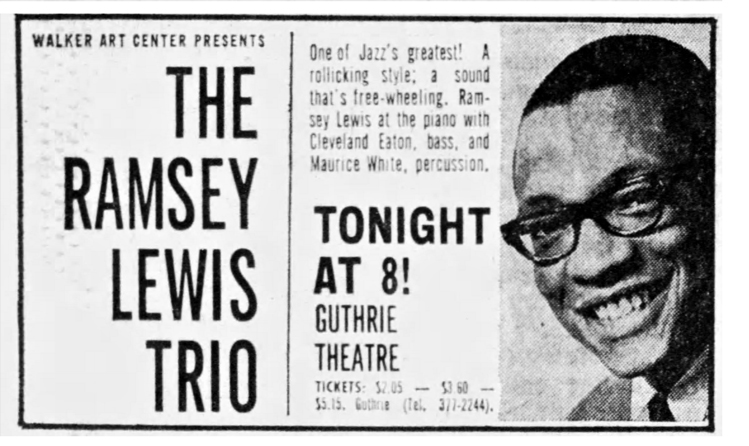
Minneapolis Tribune, September 1967
Allan Holbert at the Tribune crabbed that even though people enjoyed the show, there was nothing new or experimental about it, therefore, it wasn’t stimulating. He wanted the Walker to bring in “the new, the adventurous, the unproven jazz, the jazz that could practically be exhibited an place else in town.” Lewis’s sidemen were Cleveland Eaton on bass, and Maurice White on drums. Lewis played keyboards.
BABATUNDE OLATUNJI
Babatunde Olatunji, a troupe performing African music and dance, came to the Guthrie on November 5, 1967, presented by the Walker. This performance was in connection with the gallery’s show of Art in the Congo.
Peter Altman of the Star called it “the most relentless, enervating, overpowering total experience to be seen here in months.”
The troupe consisted of five dancers, three drummers; Olatunji was one of the drummers. He was “spreading the gospel” by taking the show around the world. He also hoped to give U.S. Negroes a sense of pride in being black by aletring them to their native cultural traditions.
PAUL BUTTERFIELD
The Butterfield Blues Band performed on November 12, 1967, presented by the Walker.
There were recent personnel changes: Elvin Bishop on guitar, Paul Butterfield on vocals and harmonica, Mark Naftalin on piano, organ, and guitar; Bugsy Maug on bass, Phillip Wilson on drums, and a three-man brass section.
A review by Jim Berman in the Minnesota Daily says that the first show was a disaster, but got better in the second. They were moving away from being a blues band and going into electric jazz. Berman especially applauded Naftalin’s keyboard skills.
Peter Altman’s review in the Star was mixed – the headline read “Almost all Electronics & No Content,” while the last line said that the concert “moved and grooved.” Again, good marks for Naftalin, who Altman called the melodic center. Butterfield’s harmonica provided the most distinctive sound, a “real Negro blues feeling.” But he felt that the group was uncohesive, and that the music was almost all electronic technique and almost no content.
Altman’s review gave no indication that there were two shows.
ROCK COMES TO THE GUTHRIE
The way I see it, the Butterfield show was the first rock act to be staged at the Guthrie. The group was not jazz, not folk, but an electric blues band that had performed at Dayton’s in May 1967, and would appear at the Depot in 1970.
Curiously, it would take a few more rock acts – notably Janis Joplin in August 1968 – for the press to pick up on the change. It wasn’t until June 1, 1969, that the Tribune had this to say:
Walker Art Center, formerly famous for its Jazz at the Guthrie concerts, is now getting into more of a Rock at the Guthrie thing.
IAN AND SYLVIA
Ian and Sylvia performed on December 1, 1967, presented by the Walker.
Ian Tyson and Sylvia Fricker were Canadian folk singers who were making their first visit to Minneapolis in six years – they used to sing at the Padded Cell. Sylvia had written “You Were on my Mind,” and Tyson had written “Four Strong Winds.”
RICHARD DYER-BENNETT
Richard Dyer-Bennett, folksinger, performed on December 9, 1967, presented by the Walker. An audience of 700 came to see him.
According to a review by Phillip Gainsley in the Star, Dyer-Bennet divided his program into four parts: three of which are geographical and one being poems of Shakespeare set to his own music. He accompanied himself on the guitar and lute. He was called back for several encores, in which he demonstrated his mastery of dialects and inflection.
1968
RAVI SHANKAR
Ravi Shankar performed on January 17, 1968, to an audience of about 1,500 – about 200 beyond capacity, as chairs were set up on stage behind the performers. He was supported by Alla Rakha on tabla and a woman tamboura player.
The Walker Art Center planned a lecture-demonstration the evening before Ravi Shankar’s concert. The program about the Sitar and Sarod was presented by Tony Glover and J. Pease, “students of Ustad Ali Akbar Khan” at the Walker.
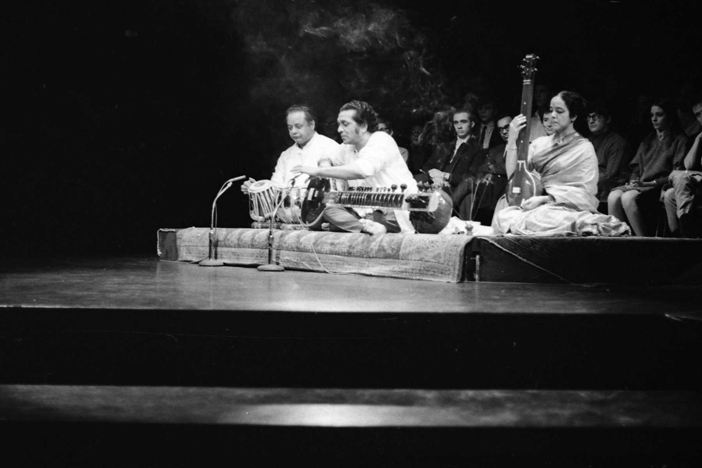
Photo copyright Mike Barich
Either before or after the show, Shankar appeared on Bill Carlson’s show “This Must be the Place.”
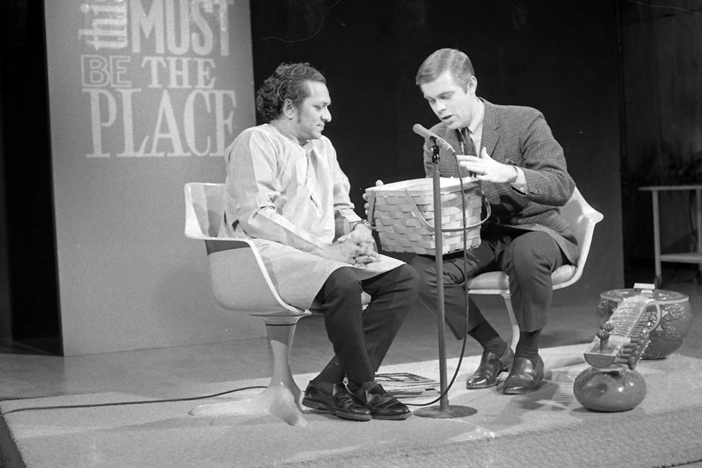
Photo copyright Mike Barich
Where magazine wrote that Shankar had left his brother’s famous dance company at age 17, where he was a star dancer, to renouse all worldly posessions and retreat t a small central Indian town to master the art of playing the sitar. After 7 1/2 years of constant practice, he began his determined mission to bring Indian music to Western audiences. Raga was enjoying an ever-growing popularity in the U.S., especially because of it by the Beatles and other rock groups.
Peter Altman of the Star noted that Shankar was voted “scenemaker of the year” in the annual Pop Eye poll of the Village Voice, and the entire “in crowd” of the Twin Cities was out in full force to see the genius of the sitar in his first local appearance. Altman deemed the performance “part brilliant artistry, part extension-division course in Oriental music, and part hip milieu.” Shankar provided copious and relatively coherent explanations of the theories behind Indian classic music, the structural elements in sitar and tabla improvisation, and the principles of Indian harmonics.
The audience came dressed in saris, Mao suits, hip-high boots, and brightly painted neckties, and Altman said they would have come away infatuated had Shankar played 653 choruses of “Three Blind Mice.” But what he did play was five pieces: an opening sitar solo, and then the long second piece involving conversation with the tabla, supported by the background of the tamoura. After intermission there was a tabla solo, another sitar solo and a second ensemble piece.
Allan Holbert of the Tribune noted that the ragas began slowly and thoughtfully, then developed into wild, swinging, entrancing climaxes. In the final number, the melodic and rhythmic action was traded back and forth between the sitar and the tabla. Holbert concluded his review with “An evening of sitar music is an exotic place to visit, but I wouldn’t want to live there every Friday night.”
JUDY COLLINS
Judy Collins performed on February 18, 1968, presented by the Walker.
She was supported by Bill Lee on bass, and Paul Harris on electric organ. Miss Collins occasionally played piano.
Collins left Peter Altman of the Star speechless, saying she makes her listener wish that he were a better person. The headline of his review read “Judy Collins Exposes Her Soul and All its Anguish.” Further into his review, he says, “She has a golden alto, breath control and vocal range that outdistance any of her rivals.”
Allan Holbert of the Tribune wrote that Collins’ material – mostly about love and war – could be called contemporary folk music, presented simply and with very little physical mostion, but with great emotional intensity.
JAZZ AT THE GUTHRIE ’68
The Walker Art Center presented another Jazz at the Guthrie series in the Spring of 1968.
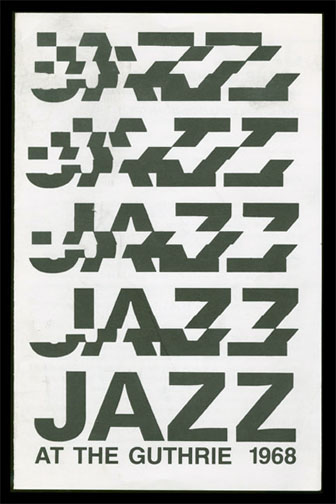
Program cover courtesy Walker Art Center
CHARLES LLOYD
The Charles Lloyd Quartet performed on April 7, 1968, presented by the Walker’s “Jazz at the Guthrie” series.
Lloyd’s Quartet included Keith Jarrett on piano, Ron McClure on bass, and Paul Motian on drums. Lloyd played tenor sax and flute
This concert was only three days after Dr. Martin Luther King was assassinated, but thankfully Minneapolis was spared violent protests and it was determined that the concert would go on. There was no mention of Dr. King at the concert, reported Allen Holbert of the Tribune.
Holbert described Lloyd’s music as “wild, far-out jazz that has been described as ‘post avant garde.'”
ARLO GUTHRIE
Arlo Guthrie performed on April 20, 1968, in a show sponsored by the Walker.
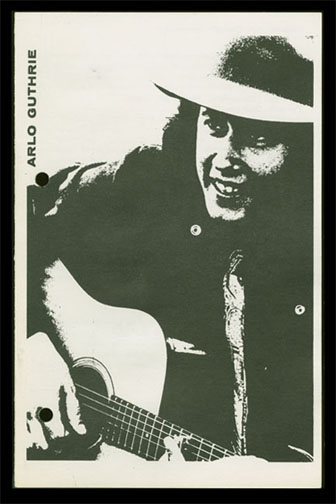
Program cover courtesy Walker Art Center
Peter Altman of the Star noted that the audience for this show was young and overappreciative of the talent of Guthrie. Altman found Guthrie to be funny and ready to be an opening act, but not the star.
The obscure, sitar-flavored, semi-agonized singing lacked charm, individuality, life and impact. Guthrie’s flair is for comedy – droll, slow, anti-authority comedy – and he should stick to it… I found his concert dull and misdirected. For a short program, it was too long.
JAZZ ’68
GARY BURTON
The Gary Burton Quartet performed on April 28, 1968, presented by the Walker’s “Jazz at the Guthrie” series.
Burton was formerly a sideman with George Shearing and Stan Getz, and his group’s sound was described jazz/rock, a new sound in the jazz field. Burton played the vibraharp (vibes), and his group was Larry Coryell on electric guitar, Steve Swallow on bass, and Bob Moses on drums. (Where magazine, April 27, 1968)
Allan Holbert of the Tribune wrote that Burton’s jazz, based mostly on original tunes, required more than one hearing to be fully appreciated. The result of the music is fascinating, but not easy to comprehend.
MILES DAVIS
The Miles Davis Quintet performed two concerts on May 26, 1968, presented by the Walker’s “Jazz at the Guthrie” series.
Davis’s backup musicians were Wayne Shorter on tenor sax, Herbie Hancock on piano, Ron Carter on bass, and Tony Williams on drums. Davis played trumpet.
Peter Altman of the Star called Davis “supercool and hypertense at the same time,” walking offstage whenever he wasn’t playing. He performed one number before intermission and three nonstop afterwards afterwards, for a total of 1 3/4 hours of playing time.
MOSE ALLISON
The Mose Allison Trio performed on June 23, 1968, presented by the Walker’s “Jazz at the Guthrie” series.
Allison performed with two sidemen: Pete Magadini on drums, and Walt Booker on bass.
Allan Holbert of the Tribune explained that Allison was a white man from Tippo, Mississippi who sounded black. At the beginning of each half of the concert, Allison did some straight piano instrumentals. “He has a voice like a lazy, velvet – toned, tenor saxophone.” Holbert wrote that Allison’s jazz wasn’t avant garde, or even modern. “But it was melodic without being repetitious and it makes you want to listen and it makes you want to move.”
MUDDY WATERS
Muddy Waters and his Band performed on July 14, 1968, presented by the Walker. See an ad on Robb Henry’s blog.
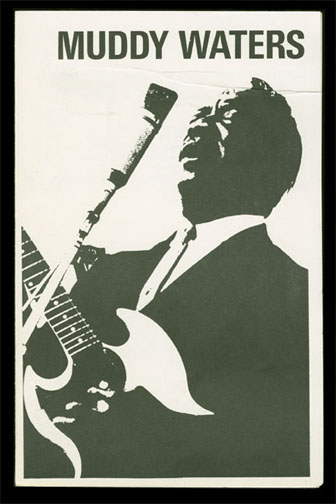
Program cover courtesy Walker Art Center
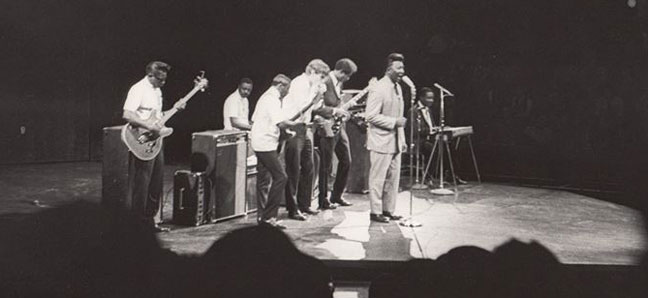
Muddy Waters (guitar and vocals), Otis Spann (piano and vocals), Sammy Langhorn (lead guitar), Luther “Georgia Boy” Johnson (bass and vocals), S.P. Larrie (drums), Paul Oscher (harp).
Tom Scanlan of the Star wrote that Waters and his band blew the roof of the Guthrie. Waters opened with a half dozen slow, intense numbers from the 1940s and ’50s before turning over the rest of the first set to his rock band. In the second half, Waters returned to do three numbers, using “weird chords and odd jumps … at once more old-fashouned and farther out than anybody on stage.” Then Otis Spann took over.
JANIS JOPLIN
Janis Joplin with Big Brother and the Holding Company performed on August 18, 1968, presented by the Walker. The date had been changed from August 11.
Janis was 25 years old at the time, and had been with Big Brother since 1966. Members were Peter Albin on bass, David Getz on drums, James Gurley and Sam Andrew on guitars. The group’s LP “Cheap Thrills” had just been released that month.
The Promo in Where magazine is slightly amusing:
Another folk-rock group, this one from the West Coast, performs at the Guthrie Theater Sunday, August 18. Big Brother and the Holding Company, a four-man and one-woman group, is being sponsored by the Walker Art Center. The woman of the group is 25-year-old Janis Joplin, a Texan who is considered the top while blues singer today. She joined the Big Brother group when it was formed in 1965. The five project the emotions about which they are singing with a power that has nearly mesmerized audiences. The present an exciting combination of blues, rock, folk and spiritual rhythms from the irreverent to the zany, with a good measure of humor. (August 1968)
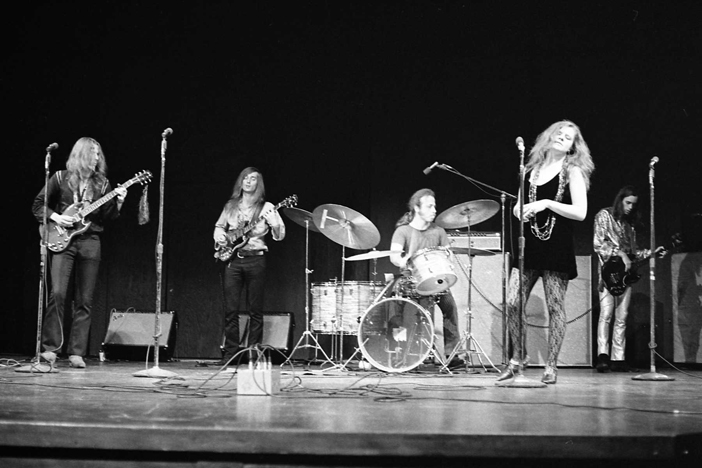
Photo copyright Mike Barich
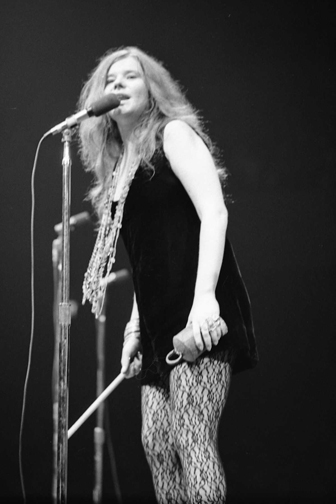
Photo copyright Mike Barich
Janis waves as she leaves the building. Mike says the photo below was the last frame on the roll, accounting for her fingers being cut off. Also, there was (of course) Southern Comfort in her cup.
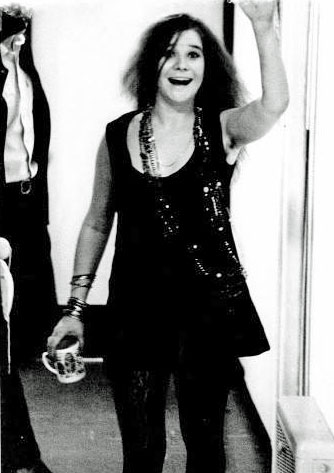
Photo copyright Mike Barich
Allan Holbert of the Tribune didn’t like the volume or the talent of the band, but he deemed Janis “an exceptionally talented performer. She has stage presence bursting out all over the place. Really confident. She bumps and grinds like and kind of a young Mae West. She has a fantastic voice that will do about anything for her, although she does seem to mistreat it.” He compares her performance to a minstrel show, where, instead of using black face, she uses black voice.
Daniel Marston of the Star was quite descriptive of her performance:
Janis sang, screamed, stomped, pleaded, and cried, holding the audience in a spell until the last cooing syllable – and thunderous, cathartic, ear-splitting crescendo. The concert felt like a baptism, like a rite of purification and cleansing.
Somewhere I read that Big Brother noted that it was the first time they had played in a theater venue with no light show and no dancing, but I have no citation for this.
DOC WATSON
Doc Watson performed on September 15, 1968, presented by the Walker. He was accompanied by his son Merle.
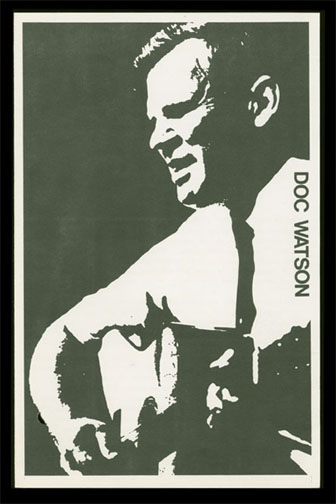
Program cover courtesy Walker Art Center
Peter Altman’s review in the Star reveals that Watson was a blind guitarist and singer from North Carolina. He was a scholar of folk and bluegrass music, tracing the histories of songs as far back as Elizabethan England. The first half of the program was dedicated to old-time music. After intermission he played songs by popular country singers.
DICK GREGORY – CANCELLED
Dick Gregory was scheduled to appear on October 6, 1968, sponsored by the Institute of Afro-American Studies. The appearance was cancelled because too few tickets were purchased.
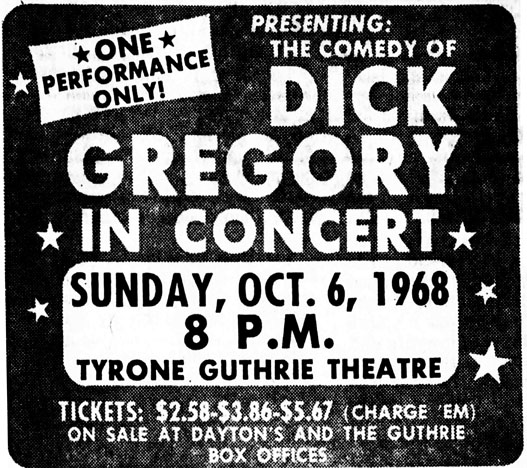
Minneapolis Tribune, September 1968
FLATT AND SCRUGGS
Flatt and Scruggs, with the Foggy Mountain Boys, performed on October 13, 1968, presented by the Walker.
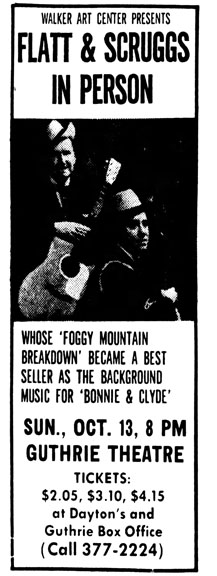
Minneapolis Star, September 1968
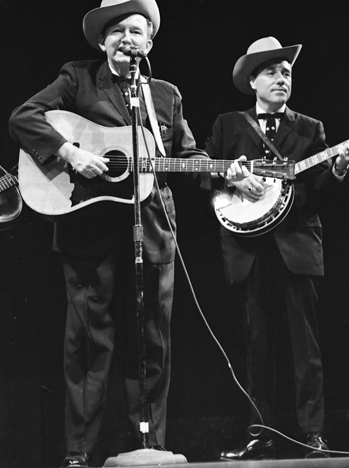
Flatt and Scruggs – Photo copyright Mike Barich
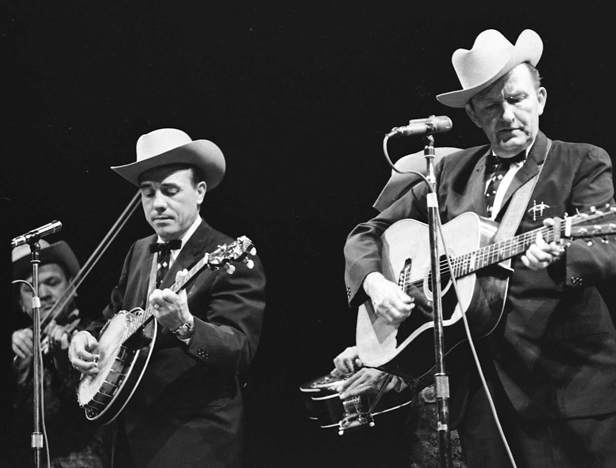
Photo copyright Mike Barich
Daniel Marston’s review in the Star called Flatt & Scrugg’s music “fast and friendly,” and their humor refreshing. They played their most famous song, the Theme from the Beverly Hillbillies” and presumably songs from the soundtrack of the film “Bonnie and Clyde.” They were accompanied by the Foggy Mountain Boys, who were not listed in the program.
UNITED STATES OF AMERICA – DID NOT HAPPEN
There was one ad that the band The United States of America was to perform on October 20, 1968, presented by the Walker. But then no more was said about it. Wikipedia says that the band was seriously breaking up about this time.
Charles Helm wrote:
I’m a fan of this band and was surprised to see them listed in Walker’s own archival list of past shows. I dug out my CD reissue of their only album – the leader Joseph Byrd wrote extensive liner notes for this reissue that describe the very few live shows they played on the “tour” they attempted after the album came out. They only played three or four cities and Byrd described in detail each show in each town; most went badly. Minneapolis (and Guthrie) wasn’t one of the cities they played…they broke up after the tour. Guessing that a Guthrie date was, at some point in the works, hence the file on them or single ad listing but no one threw away the file when the gig didn’t come together or was cancelled.
ODETTA
Odetta performed on November 17, 1968, presented by the Walker.
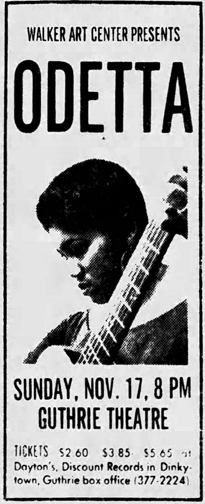
Minneapolis Star, November 1968
Peter Altman of the Star wrote that Odetta’s music seemed dated, and when she tried to be more contemporary, she seemed to be contriving her act superficially. She still had her huge, deep voice. Disturbingly, Altman observed, “She talks, like many people nowadays, about love and togetherness, but one cannot ignore in her remarks an unadmitted undercurrent of racial hostility and resentment.”
Blood, Sweat & Tears was originally scheduled for December 8, 1968, but the concert was postponed due to illness. The show was held on January 16, 1969.
1969
BLOOD, SWEAT & TEARS
Blood, Sweat & Tears appeared at the Guthrie on January 16, 1969, presented by the Walker.
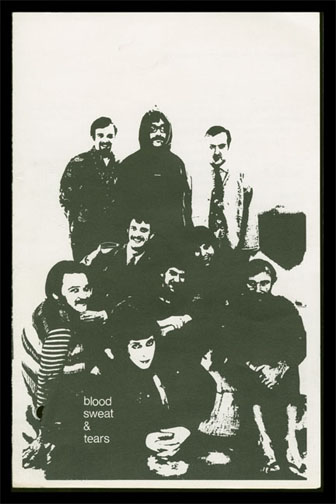
Program Cover Courtesy Walker Art Center
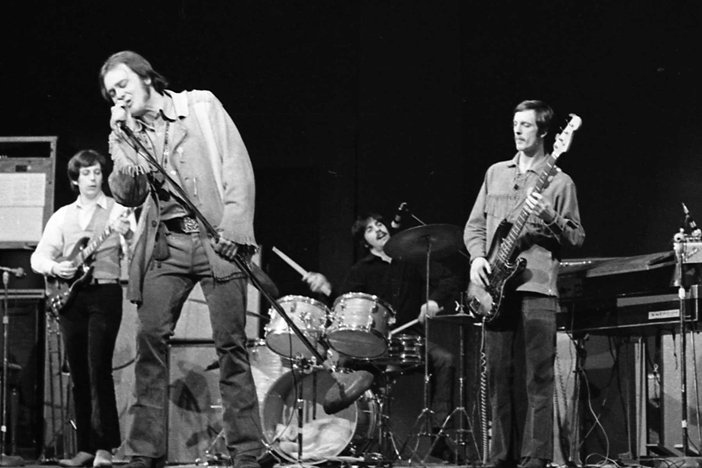
Photo copyright Mike Barich
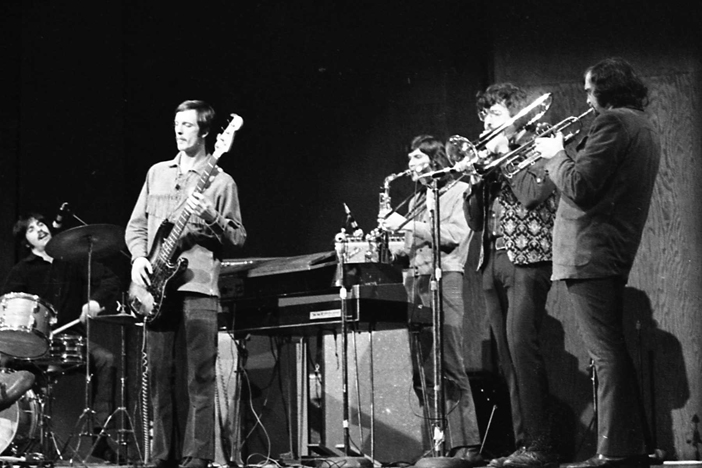
Photo copyright Mike Barich
Their eponymous album came out that February. Warren Walsh: “I was disappointed as I expected the Al Kooper line-up but quickly forgave them when David Clayton-Thomas powered up.”
The show started almost an hour late, because one of their nine members – a trumpet player – couldn’t make it and they had to do a bit of extra rehearsing with a substitute. When it did start, the show lasted less than an hour. But reviewer Allan Holbert of the Tribune called it “one of the most exciting hours of music – classical, jazz, rock, or anything – that’s been heard around here in quite a while.” He was mightily impressed with Clayton-Thomas’s voice, which he thought sounded as black as can be. He noted that the sound wasn’t perfect because the group had to borrow local equipment for some of their own which was lost or broken in transit.
Peter Altman of the Star wasn’t as forgiving. The 45 minute wait to get in was “outrageous amateurism,” and the short show left their fans “disgruntled even more than waiting had.” The “noise” could have “drowned out an atomic explosion,” and when the whole band plays at once, it is a “deafening cacophony.” But all in all, those things could be overcome, and he saw much talent in several of the players, and wrote that the group’s music has “force, complexity, imagination, and soul. On a more professional occasion, I’d like to hear more.”
PETE SEEGER
Pete Seeger performed on March 22, 1969, presented by the Walker. It was a sellout crowd, with overflow seating on the stage behind him.
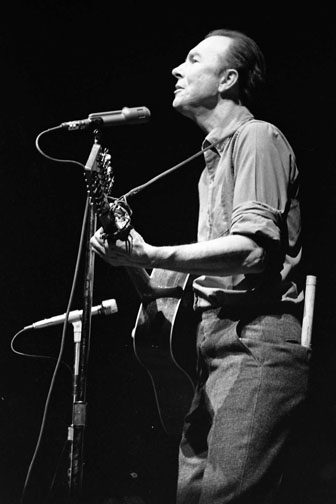
Photo copyright Mike Barich
Accompanying himself on the banjo or the 12-string guitar, Seeger ran the gamut of folk tunes, including love songs, protest songs, sing-a-long songs (not popular among shy Minnesotans), old songs, and his own songs. He moved from one side of the stage to the other in consideration of the people seated on the stage behind him.
MICHAEL LESSAC
Local folk singer Michael Lessac, with Music Projection, performed on March 30, 1969.
Michael Lessac
Allan Holbert of the Tribune wrote that Lessac was a guitarist, singer, composer, and teller of not-always-funny stories. His songs and lyrics could be described as in an “urban folk style.” Lessac was once in the Metropolitan Opera children’s chorus and his father is a voice teacher. He was backed by Bill Perlman on guitar, Doug Kenny on electric bass, and Tony Glover, who played mouth harp on a couch the entire evening.
Music Projection
The warmup group was called the Music Projection – four guitarists, a drummer, and two girl singers who Holbert wrote did an excellent job.
LED ZEPPELIN
Led Zepplin played the Guthrie on May 18, 1969, presented by the Walker.
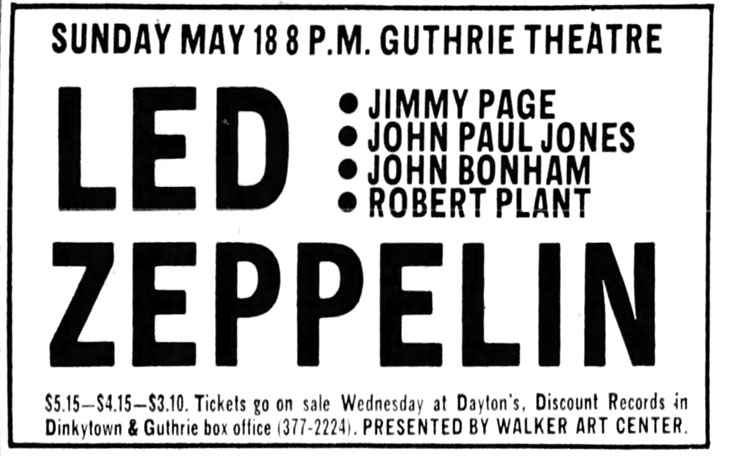
Minneapolis Tribune, April 1969
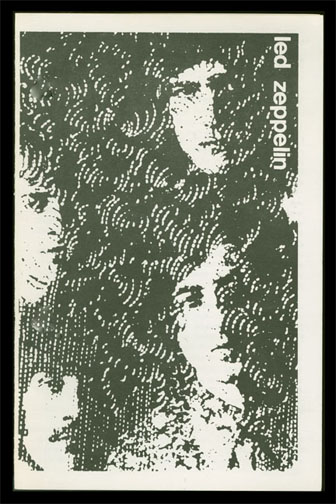
Program cover courtesy Walker Art Center
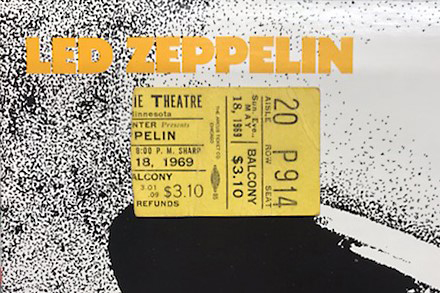
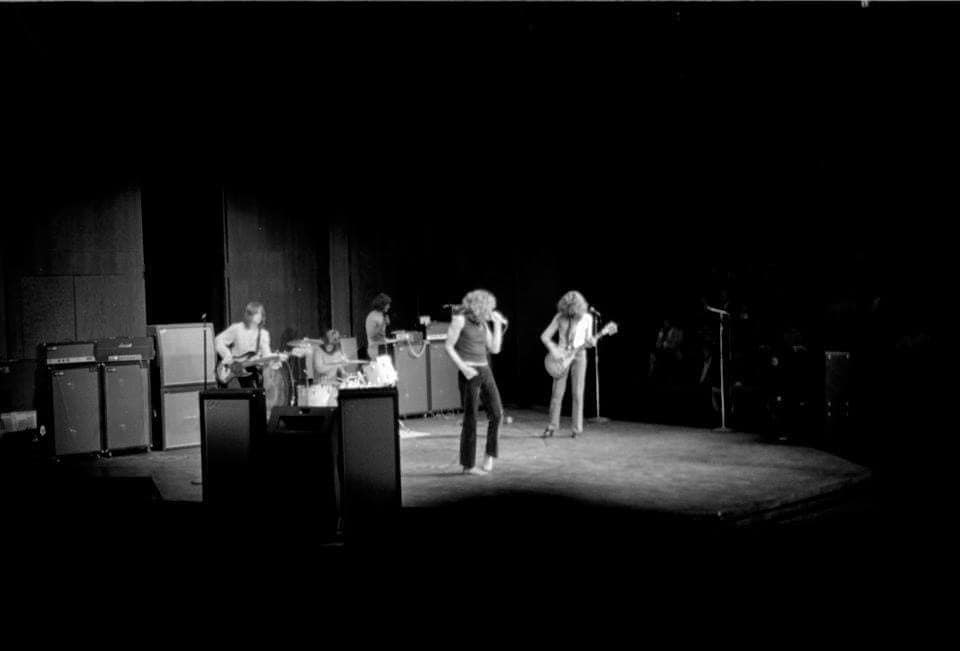
The band started late; they had trouble with the borrowed equipment they had to use when their own PA system was damaged in transit. And reviewer Peter Altman of the Star complained about how loud it was. But this time it was Altman who said it was the the strongest music heard in the Guthrie in quite some time. “It revealed not just four players of extraordinary talent but a group which understood that ensemble playing implies communication and mutual stimulation among its members. And all seemed to respect the audience.”
The leader was guitar player Jimmy Page, formerly of the Yardbirds. The others were John Bonham on drums, John Paul Jones on bass, and singer Robert Plant, who Altman described as “a masculine Janis Joplin He tortures and strains his voice to communicate desperation, uncontrollable agony and delirious joy. Plant is overwhelming.”
It was reported to be an Amazing Show – they played for 2 1/2 hours with no opening act.
THE WHO
The Who, with Koerner, Ray, and Glover, played the Guthrie on June 8, 1969, presented by the Walker. It was shortly before Woodstock. They had to add a second show as the 7 pm show sold out immediately.
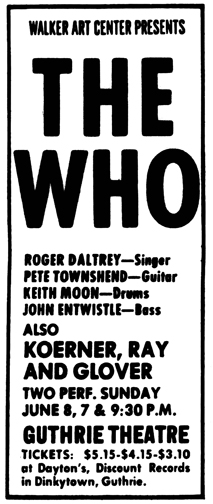
Minneapolis Star, June 1969
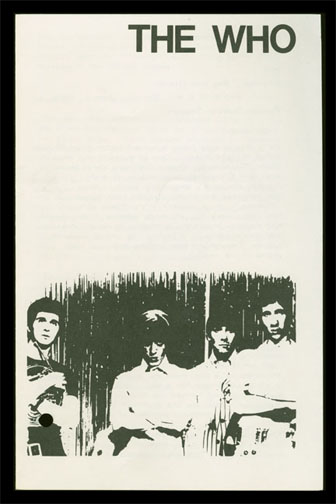
Program cover courtesy Walker Art Center
The Who
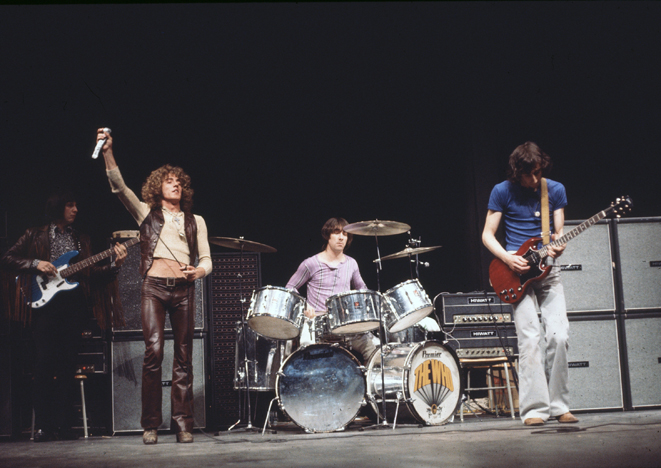
Photo copyright Mike Barich
John Entwhistle playing amongst his fringe.
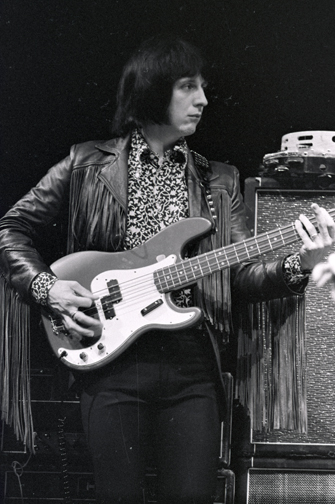
Photo copyright Mike Barich
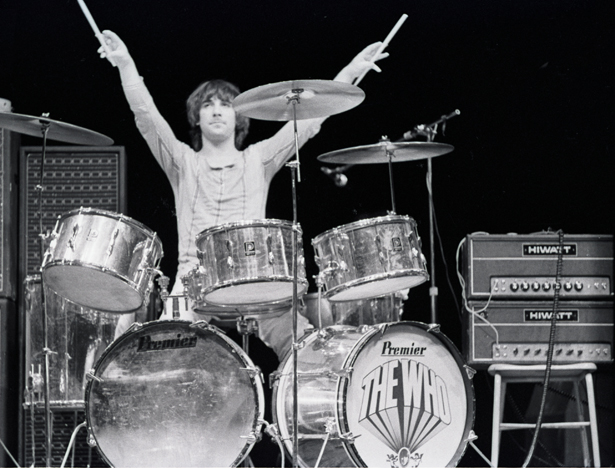
Photo copyright Mike Barich
Roger Daltry throwing the mike. Someone said he threw it halfway across the Guthrie audience.
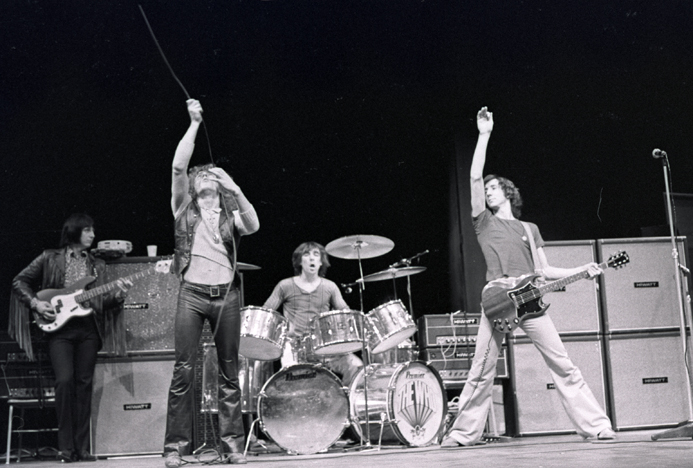
Photo copyright Mike Barich
Peter Townshend doing his signature jump.
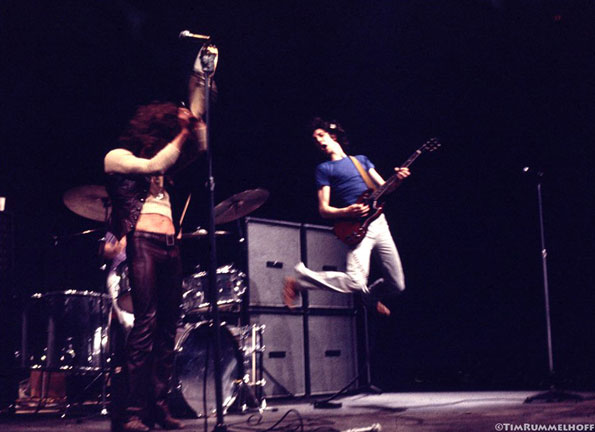
Photo copyright Tim Rummelhoff. No further use permitted
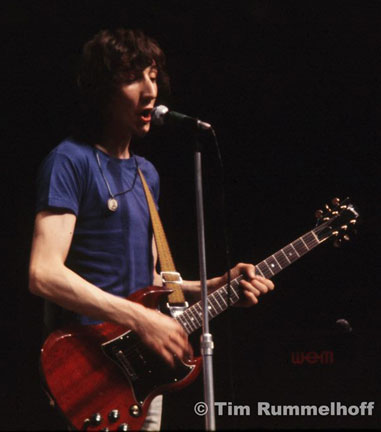
Photo copyright Tim Rummelhoff. No further use permitted
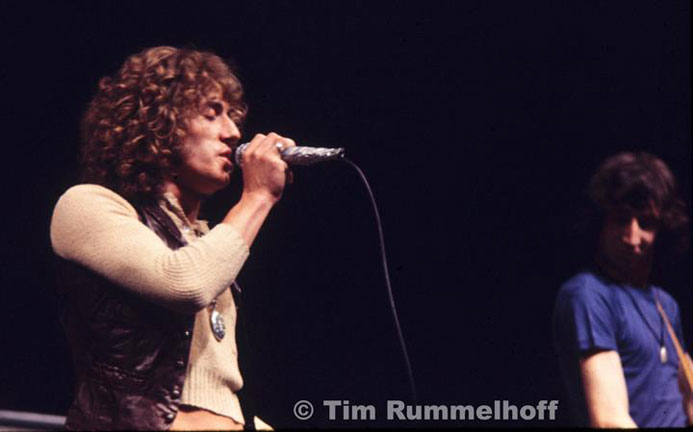
Photo copyright Tim Rummelhoff. No further use permitted
A review by Scott Bartell in the Tribune complained that the set he saw was only 45 minutes long. The first song was “Heaven and Hell,” and Bartell said that they exhibited “consistent strength, control and precision.” Bartell noted that Roger Daltry was frustrated by lack of room. “After that came about six short pieces from ‘Tommy,’ which had been released on May 23, 1969. The group went back to three old songs and ended very abruptly after a version of ‘Shakin’ All Over,’ leaving the audience unsure whether to go or stay… It was a concert worth hearing, but no one could be sure they had really heard a whole concert.”
The review in the Star, bylined by Kicky Sherman and John K. Sherman, Jr., focused on the volume, writing that the audience was “bombarded” by the sound: “Louder than a screaming jet, more powerful than a jack hammer, the Who assaulted, stunned, and delighted a largely young audience.”
Steven Adams remembered, “It was the only show I ever went to where someone in the audience asked the act to turn the volume down. Townshend refused. My ears rang for the next two days. Their ‘Live at Leeds’ album is nearly a song-for-song duplicate of their Guthrie concert.”
Party Crasher
The Insider reported that as the members of the Who smashed their equipment, “an impetuous boy who attempted to join in got as far as a couple of licks on the drum and guitar before a sideliner gave him the heave-ho. It was a dramatic ending to a bash of a concert.”
Gary Gimmestad reports:
Very near the end and leading up to the much-anticipated destruction and mayhem, Keith Moon slinked offstage while Townsend held focus. As the frenzy came to a fever pitch the floor trap opened and Moon rose out of the pit and circled back to his drums and the real destruction began. However, a stoner approached the stage, walking slowly toward Townsend with his arms outstretched. I don’t know what Townsend’s thinking was – “This guy is clearly whacked and potentially dangerous and I should just hand over the guitar,” or “What the hell, this could be interesting.” He did hand over the guitar and the energy was drained from the stage. It ended in anti-climax.
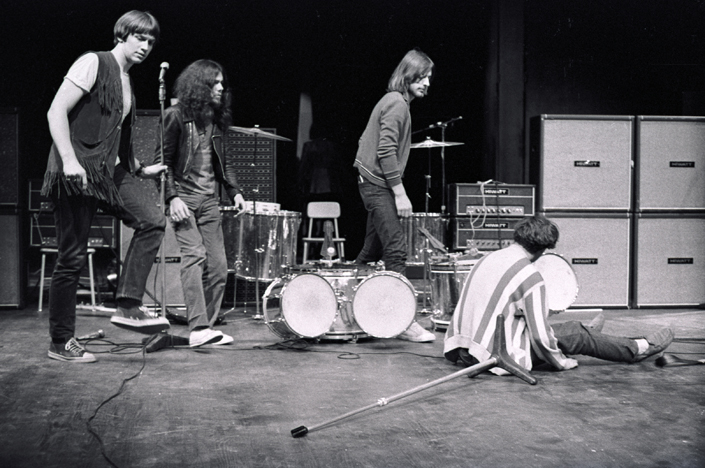
Photo copyright Mike Barich
Koerner, Ray, and Glover
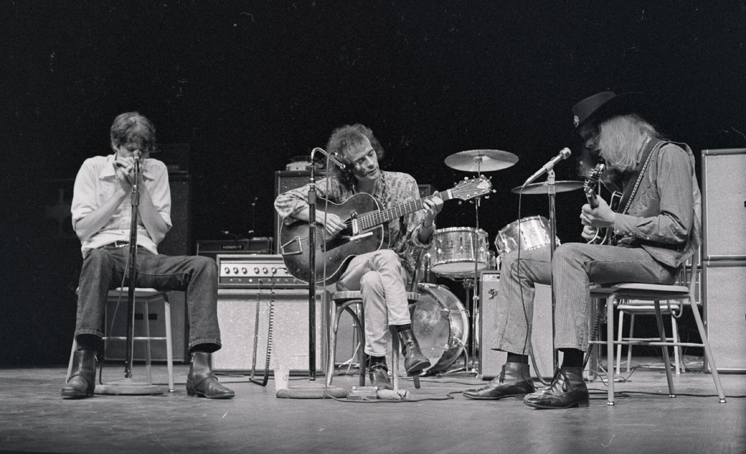
Tom Koerner, Tony Glover, and Dave Ray opening the show. Photo copyright Mike Barich
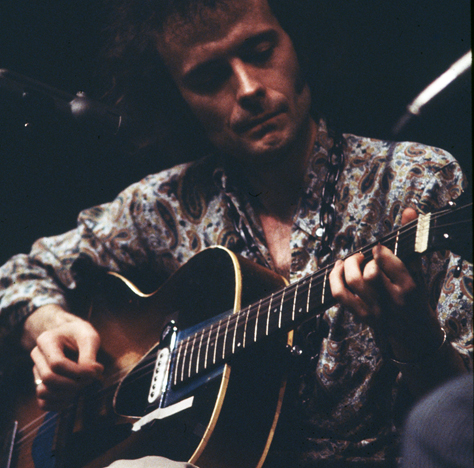
Tony Glover. Photo copyright Mike Barich
Koerner, Ray, and Glover opened the Who show and played for about an hour. It was the Guthrie debut for the trio, and Koerner told a dirty joke. Reviewer Bartell wrote that they were “not very well rehearsed but they still had their old feeling and kept a nice, steady beat.”
The Star review called the KR&G segment refreshing, and they were received warmly by the audience. They played songs from their early records and ended with the unaccompanied work song, “Linin’ Track.” The group had actually split up by this time, so this was a reunion of sorts for the trio.
JOHNNY WINTER
Johnny Winter, with the Holy Modal Rounders, appeared on June 29, 1969, presented by the Walker.
Johnny Winter
It was Johnny’s first time in Minneapolis. See a poster on Robb Henry’s blog.
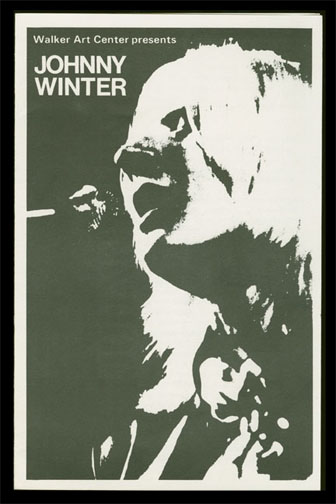
Program cover courtesy Walker Art Center
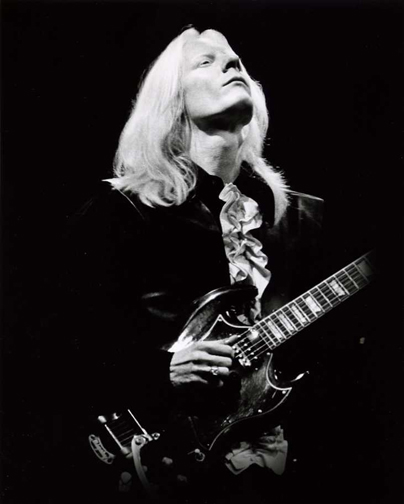
Photo copyright Mike Barich
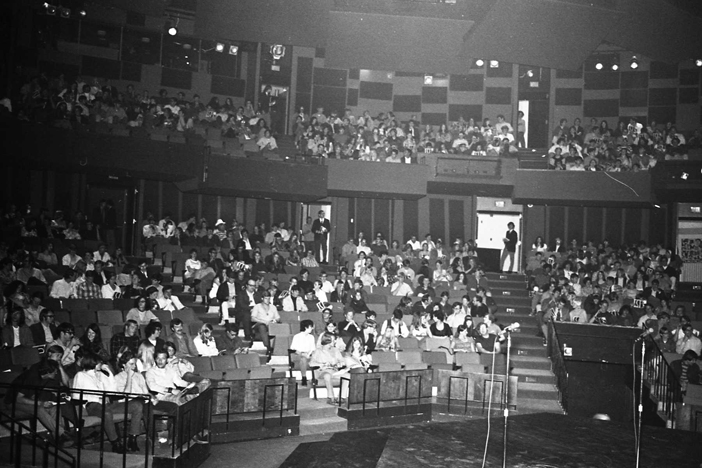
Audience for the Johnny Winter show. Photo copyright Mike Barich
Things were getting looser at the Guthrie – despite a no smoking rule at the theater, Tribune reviewer Allan Holbert wrote that one could get high just breathing the air during the Johnny Winter concert. He deemed Winter and his band “quite sensational… Winter’s sensuous dancing and body pulsations are probably best appreciated by those in the audience to young to remember Elvis Presley in his formative years.”
Holy Modal Rounders
The Holy Modal Rounders featured Peter Stampfel on a green, electric fiddle and vocals. Holbert described their act as “put-ons of old songs and country-western stuff. I think they consider themselves more entertaining than they really are.”
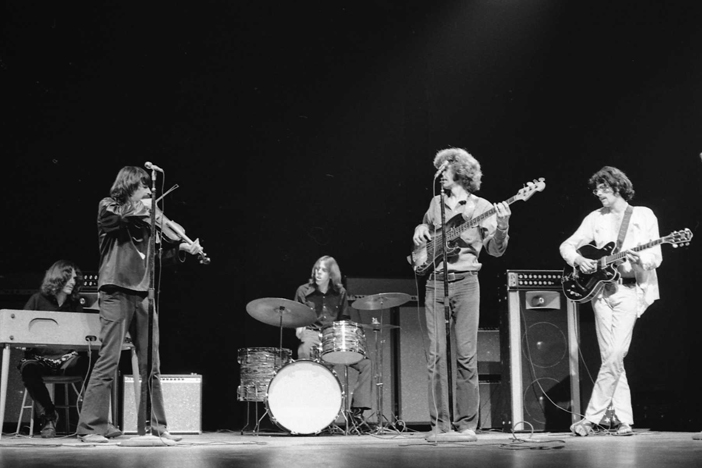
Holy Modal Rounders – Photo copyright Mike Barich
ZAPPA, COOPER
Frank Zappa and the Mothers of Invention (10 members) with Alice Cooper, performed two shows on July 13, 1969, presented by the Walker.
Frank Zappa
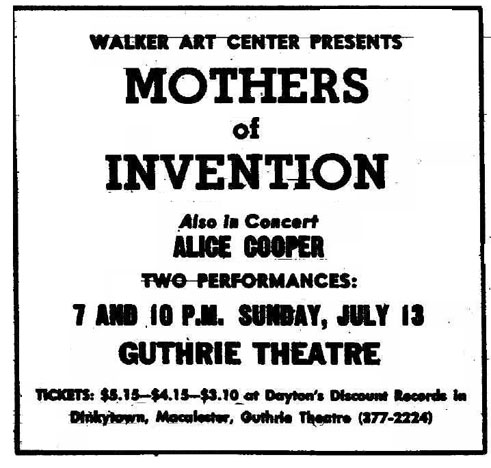
Ad from Minnesota Daily, courtesy Robb Henry
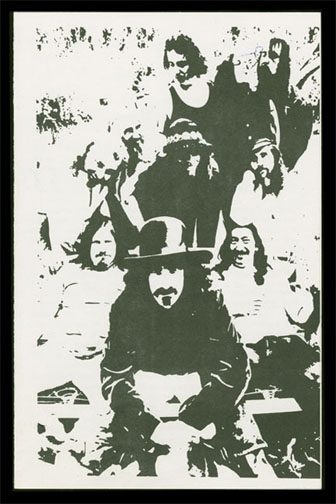
Program cover courtesy Walker Art Center
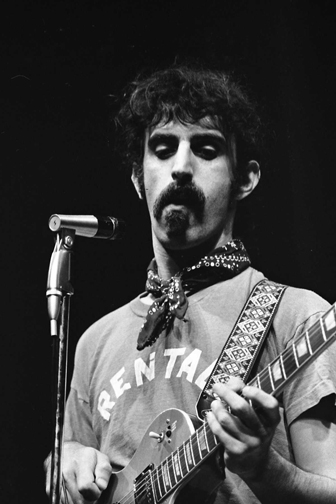
Frank Zappa photo copyright Mike Barich
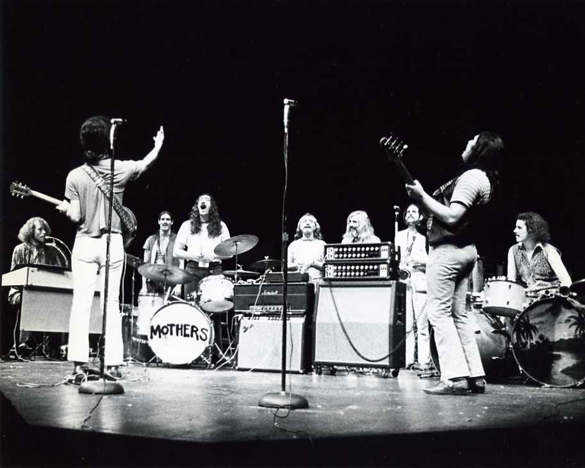
Photo copyright Mike Barich
Mike Steele of the Tribune wrote that the depth and complexity, the subtlety and compelling richness of the Mothers’ music could only be appreciated in person, and the performance at the Guthrie “musically tore the place apart.” The music defies categorization, and the band includes some of the finest musicians in the business, including leader Frank Zappa, who was called the great musical satirist of the day. The concert was deemed fantastic and exciting, with songs that were few but long.
Reportedly the Zappa show featured mostly instrumentals as it was before Flo and Eddie joined.
Alice Cooper
Alice Cooper was a Zappa discovery and had yet to release their first album. Reviewer Steele called them five gaunt maniacs who were into some very heavy music and some extraordinary theatrics. Their act was part rock group, part performance art, and it was so loud that the words were drowned out, but the performance was entertaining.
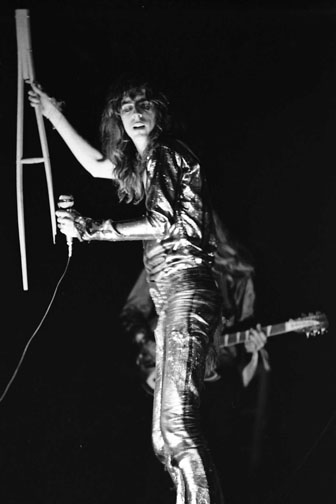
Photo copyright Mike Barich
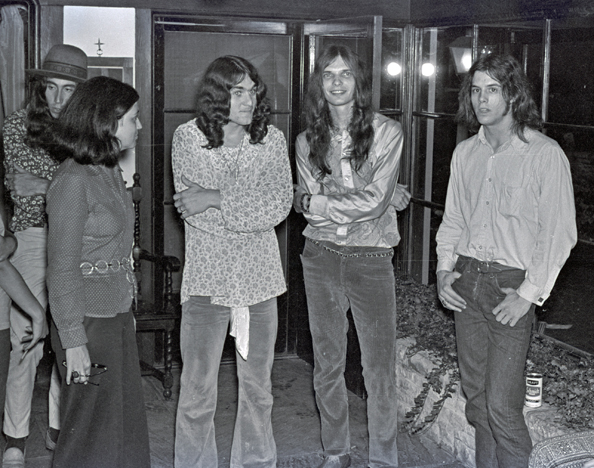
Alice Cooper backstage. Photo copyright Mike Barich
ELVIN JONES
The Elvin Jones Trio performed on July 27, 1969, presented by the Walker as a “Jazz at the Guthrie” concert.
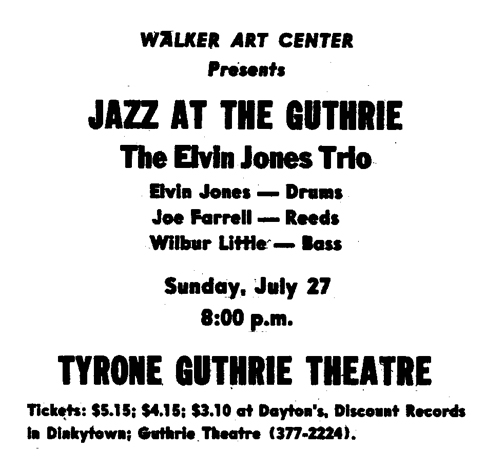
Ad from Minnesota Daily, courtesy Robb Henry
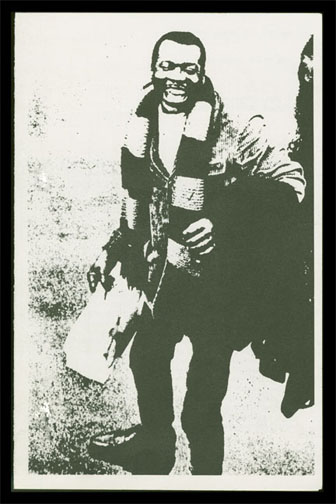
Elvin Jones Program Cover courtesy Walker Art Center
Jones was on drums, Joe Farrell on reeds, and Wilbur Little on bass.
Kicky Sherman of the Star reported that Jones performed to one of the most appreciative jazz audiences the Twin Cities has seen. The young audience gave the trio three standing ovations.
Allan Holbert of the Tribune wrote a different story. Although he said that Jones used to play with John Coltrane, he noted that the theater was half filled when the concert started, and many left at intermission. The problem?
The solos were far too long, much longer than merited by the material in them. The players, while working hard and with integrity, seemed much more interested in entertaining and impressing themselves than their audience.
FLEETWOOD MAC – CANCELLED
Fleetwood Mac was scheduled to appear on August 3, 1969, but on the day of the show the Minneapolis Tribune announced that the the show was cancelled, as was the entire tour. A telegram in the program file from their New York agent says “Having probles with Fleetwood Mac immigration.” At the time, members of the group were:
- Peter Green, guitar, vocals, harmonica
- Jeremy Spencer, guicar, vocals, piano
- John McVie, bass
- Mick Fleetwood, drums
KOERNER & MURPHY
John Koerner and Willie Murphy performed on August 24, 1969, presented by the Walker.
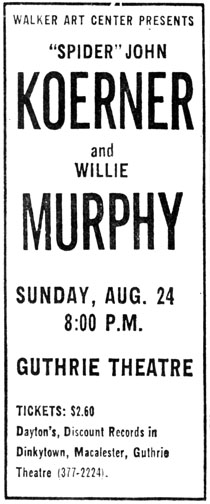
Minneapolis Tribune, August 1969
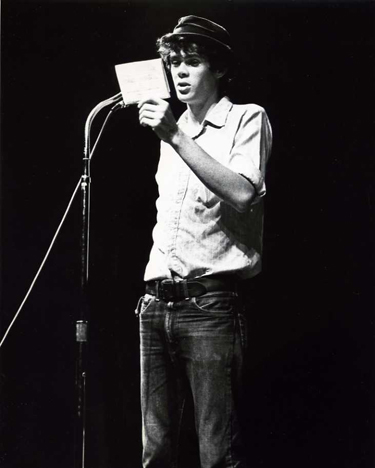
John Koerner – Photo copyright Mike Barich
Carol Buckman’s review of this show in the Tribune starts out by saying that the stripper that Koerner and Murphy had planned to add to their show had to go, according to State law. So the show went on without her. The two were accompanied by two Frenchmen, she wrote: Bruce Menier, a stern-faced bass player, and Robert Grenier, a toothless drummer.
During the first half, Willie sat slumped over his piano, occasionally smiling through his thick red beard and long, wavy hair. After intermission, he “came out of his beard” and sent out lyrics of blues.
The two teamed up about two years before, and attracted an audience of mostly college freshmen and high school students wearing beads, beards, and granny gowns.
CHUCK BERRY
Chuck Berry, with Spider John Koerner and Willie Murphy, appeared on September 7, 1969, presented by the Walker.
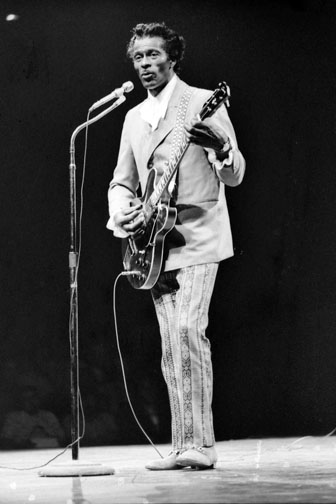
Photo copyright Mike Barich
The show was reviewed by U of M student Walter Lide for the Star, who reported that there were hardly any teenyboppers in sight. He also reported that his backup band “stank.” Berry is known for hiring local bands in the towns he plays and allowing little time for rehearsal. Also, Lide reported that, although Berry got a five-minute standing ovation, he did not return for an encore.
Sherwin Linton, our local country singer and teller of fantastic tales, has another wonderful story to share with us about meeting Chuck Berry during this stop in Minneapolis:
On September 7, 1969, I attended the concert by Chuck Berry sponsored by the Walker Arts Center at the Tyrone Guthrie Theater. Chuck came out onto the stage for a few minutes past the starting time and announced that the show would be opening in a few minutes, as soon as some business was settled. I assume he was demanding to be paid in cash prior to performing. He then returned to the stage. I believe there was an opening act which must have been Spider John Koener and Willie Murphy. I was not familiar with them at that time. As I recall three musicians waited on stage, bass, drums and guitar.
When Chuck returned he went into his opening song and very soon realized the back-up musicians were not familiar with his music and turned to them and told them they did not need to play. He did the whole show, just himself and his guitar. He introduced the song “My Ding-a-ling,” which he had not yet recorded. I wrote down some of the lyrics on my program and began performing it on my shows as a novelty song.
Following the show when I left the theater I saw Chuck walking toward Mt. Curve Ave. and caught up with him and asked if he would autograph my program. He said, “Are you with someone?” and I responded, “Yes, my wife.” He said, “I have to leave quickly, you can get into my car and ride to the corner and I’ll sign it and you can walk back.” He put his guitar and a briefcase into the car. I jumped in and he drove to the corner of Hennepin and signed the program Charles Berry. I thanked him and got out and returned to meet my wife at the theater.
I could not believe it, I had ridden with Chuck Berry. I have read so much about Chuck Berry and with the knowledge of what I have read I am even more amazed. Chuck Berry never trusted anyone. I have also been told it is very rare that he signed his name as Charles Berry. A highlight of his program was a narration of a poem he had written titled “My Dream,” which I have only found on one album, “San Francisco Dues.” His recorded version is six minutes and varies slightly from his live version of the Guthrie performance. I have seen Chuck Berry several times but meeting him, getting his autograph and riding in his car is an exceptionally special memory and highlight and this signed program is a treasure.
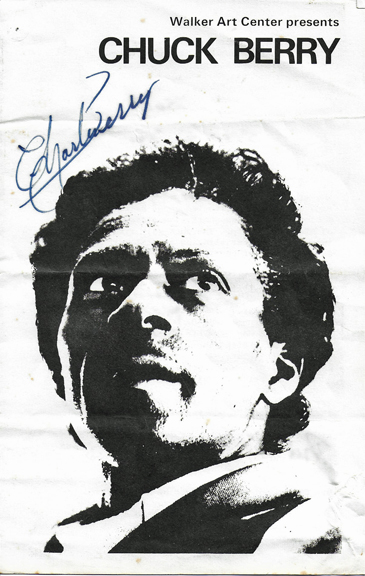
Front of program with autograph, courtesy Sherwin Linton
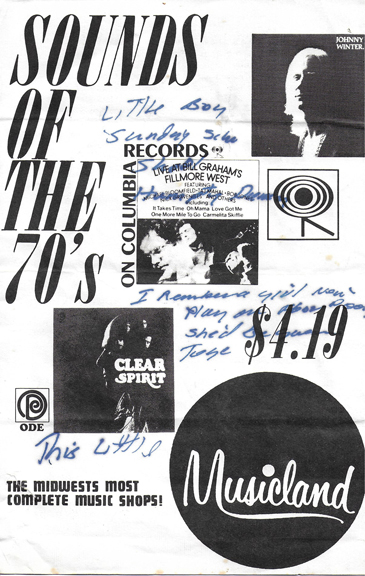
Back of program with song notes, courtesy Sherwin Linton
SILVER APPLES
Silver Apples appeared on October 5, 1969, presented by the Walker. The theater was less than half full.
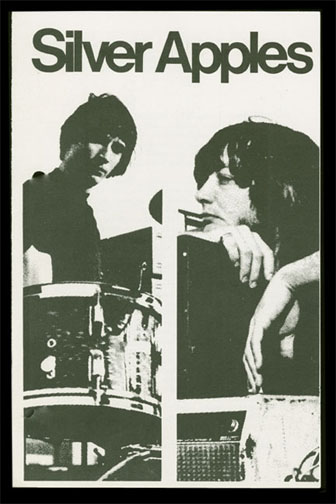
Program Cover courtesy Walker Art Center
Silver Apples was made up of of a synthesizer named Simeon, the synthesizer’s inventor (Simeon Coxe III), and a drummer named Danny Taylor.
Mike Steele of the Tribune was unfulfilled:
First of all, Simeon was used in most of the group’s numbers as an organ would be, both for melody and bass. Only in a couple of numbers, the group’s best, did they pull the stops and use electronic music as electronic music with all its strange sound waves, oscillations, squeaks, squeals, wails and moans.
The other things a synthesizer does well involves multiple over-dubbing and sound effects – strange, new sounds that have been very effectively used with rock bands. But it’s almost impossible to get all those effects with one man running the machine trying to cover four instruments and sing as well.
Their concert has all the excitement of a drum solo, but all the dullness of an evening of nothing but drum solos.
Walter Lide of the Star was a little stunned. His review starts, “I saw them, but I really don’t believe them.” After much explanation, he wrote that the instrument sounds really good, and urged people to catch them next time around.
STEVE MILLER
The Steve Miller Band, with the Bonzo Dog Doo Dah Band, appeared for two shows on October 12, 1969, presented by the Walker.
The Steve Miller Band
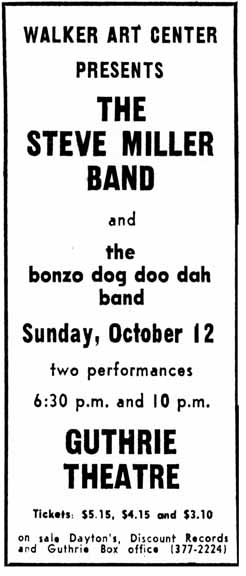
Minneapolis Tribune, October 1969
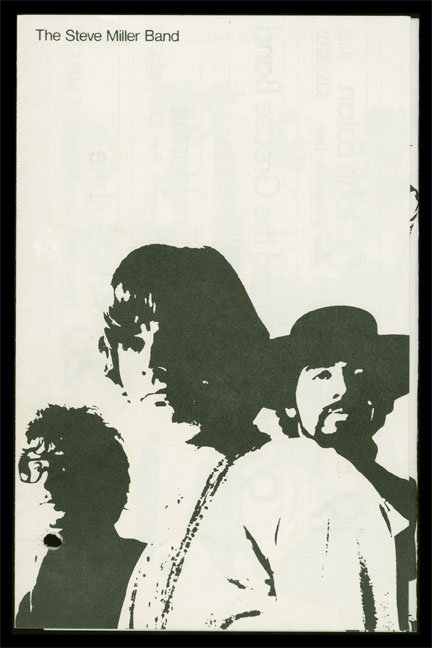
Program Cover courtesy Walker Art Center
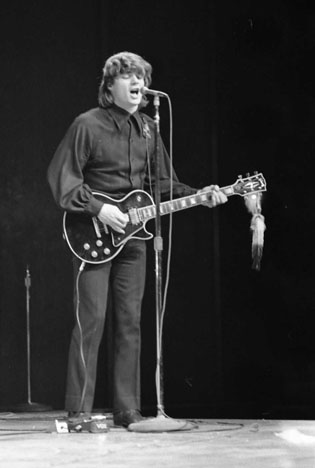
Photo of Steve Miller copyright Mike Barich
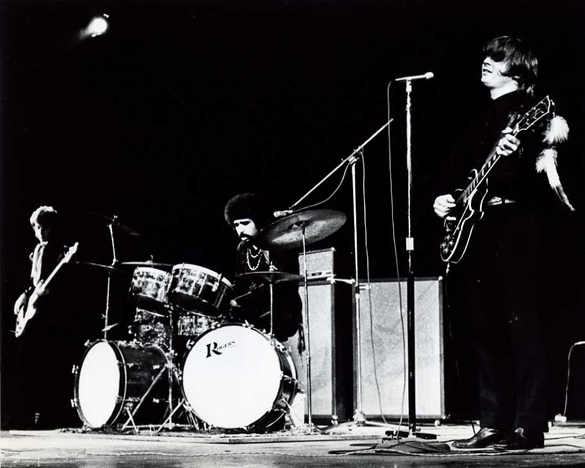
Photo copyright Mike Barich
The Steve Miller Band consisted of Steve Miller, Tim Davis, and Lonnie Turner.
Marshall Fine’s review in the Star was hard on the band, calling it too derivative of songs by Cream, Bo Diddley, Chuck Berry, and others. Fine called them entertaining, but overshadowed by their opening act.
Allan Holbert’s review in the Tribune noted the Miller band’s excellent musicianship they used to produce a throbbing, hard-driving kind of rhythm and blues rock. He liked Miller’s harmonica playing better than his singing, but it improved when joined by drummer Tim Davis.
Bonzo Dog Doo Dah Band
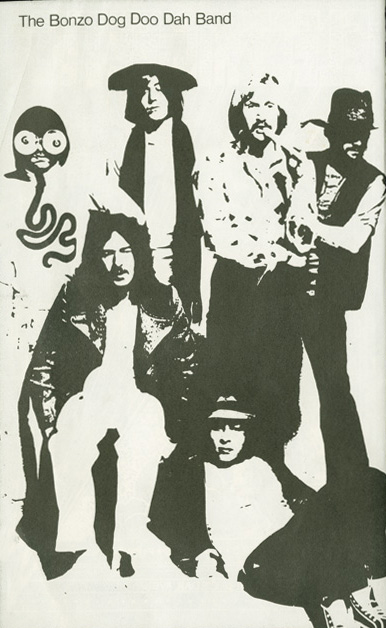
Program cover courtesy Walker Art Center
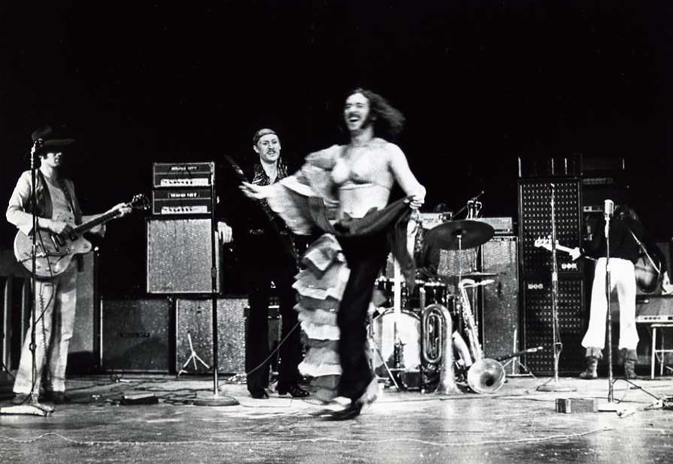
Photo copyright Mike Barich
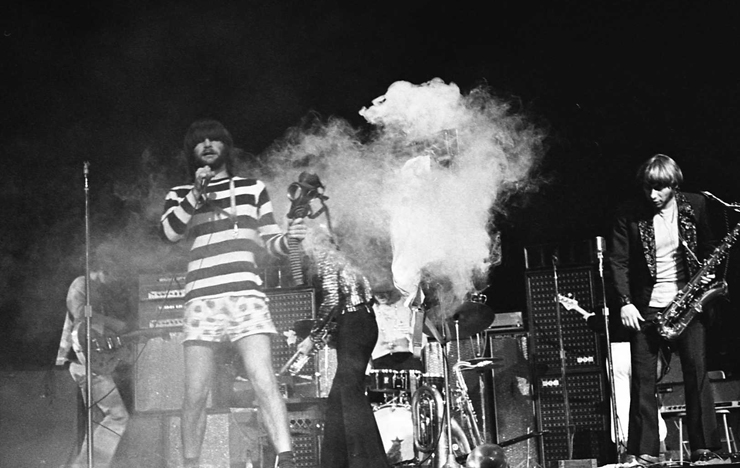
Photo copyright Mike Barich
The Bonzo Dog Doo Dah Band started when they were all in art school together. Members were Vivien Stenshall, Neil Innes, Larry “Legs” Smith, Rodney Slater, Roger Spear, and Dennis Cowan.
Marshall Fine called the “Dog Band” “an English Mothers of Invention” that did old vaudeville routines during instrumental passages. They had weird machines that sprayed feathers and blew bubbles, and they executed well-done pantomimes. Group leader Vivien Stanshall picked his nose while imitating Elvis, and did a very graphic and funny impression of an overly-endowed stripper. From the pictures, underwear seems to be a key part of the show…
Holbert called the band “one of the craziest, most absurd and most entertaining rock type shows I’ve ever seen. What they have is kind of an English and updated version of the old Spike Jones band.” Holbert praised their musical abilities as well.
B.B. KING
The B.B. King Band appeared on October 19, 1969, presented by the Walker. The house was at capacity.
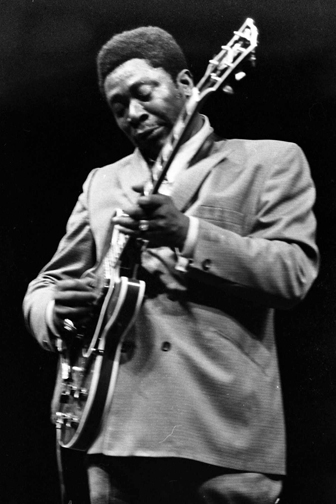
Photo copyright Mike Barich
Reviewer Peter Altman of the Star reported that King’s concert was presented as if the Guthrie was a nightclub, with King providing comic commentary along with the music. He had a large, jazz-inclined band with three horns. The performance was deemed notable for musical traditionalism, personal warmth, and showmanship.
JOHN EATON
John Eaton and his Moog synthesizer appeared on November 2, 1969, presented by the Walker.
Eaton played an instrument called a Syn-ket, accompanied by Dick Bortolussi on drums and Clyde Anderson on bass.
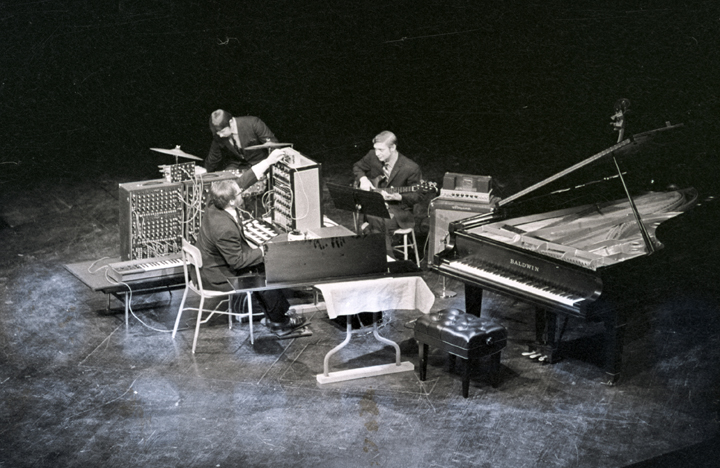
Photo copyright Mike Barich
Mike Steele of the Tribune called Eaton a member of the new generation of electronic composers, and the only performer who works live with the Syn-ket and the Moog Synthesizer. His music ranged from extremely cerebral compositions to jazz improvisations.
JOE COCKER
Joe Cocker and the Grease Band, opened by the Sons, performed on November 9, 1969. This was Cocker’s first Twin Cities appearance. It was a packed house.
Tony Glover himself reviewed the show for the Star, saying that nobody recognized Cocker at first since he had grown a wooly beard. He opened with “She Came in Through the Bathroom Window.” He also did “With a Little Help From my Friends” at the end, with an encore of “Delta Lady.”
The Grease Band consisted of Christ Stainton (piano and organ), Bruce Rowland (drums), Allen Spenner (bass), Henery McCullough (guitar), and Bobby Torres (occasional conga drums).
He returned on December 14, 1969 to perform at the Prison in Burnsville.
The Sons
The opening act for Joe Cocker and the Grease Band was a group called the Sons, formerly the Sons of Champlin. Members were Bill Champlin on bass and vocals; Terry Hagerty on lead guitar; Geoff Palmer on Keyboards, vocals, and saxophone; and Tim Cain on sax. They were based out of San Francisco.
Tony Glover called them a surprisingly tight and textured group, with a sound that was more cerebral than “gut-rock.” They had a good sense of timing and dynamics in their program of original material. Glover reported that the Sons got respectful if not ecstatic response from the crowd.
Mike Steele of the Tribune reported that the Sons were one of the tightest, most together groups he’d heard – no-nonsense, no-hype, perhaps not the best show band, but one of the best purveyors of rock to hit the Guthrie. Like Glover said, they weren’t overly loud.
TIM HARDIN
Tim Hardin performed on November 16, 1969, presented by the Walker. The show was sold out.
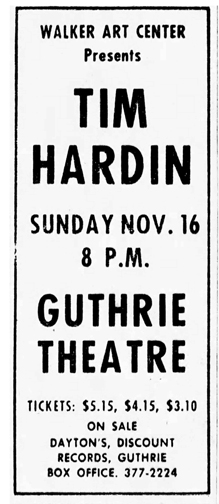
Minneapolis Tribune, November 1969
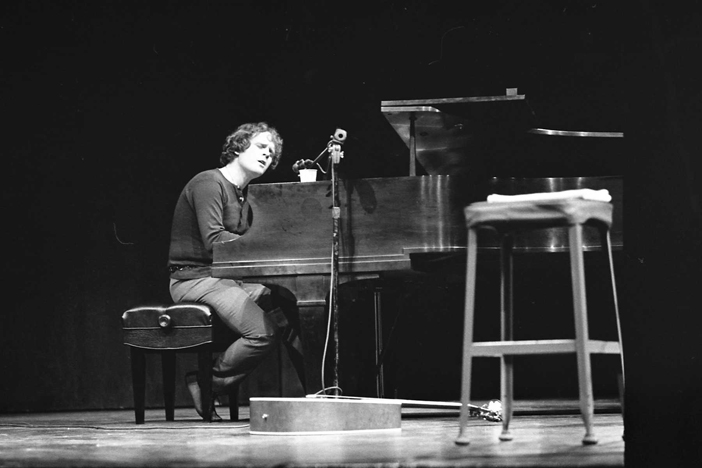
Tim Hardin photo copyright Mike Barich
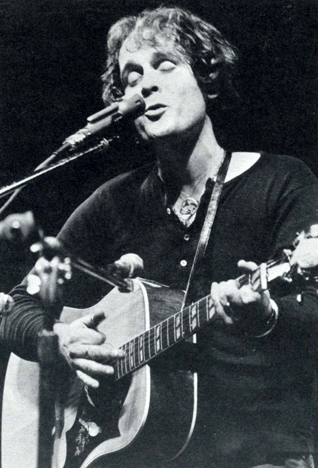
Tim Hardin photo copyright Mike Barich
Mike Steele of the Tribune wanted to like Tim Hardin – after all, he had written some great songs, but after a while he perceived that Hardin wasn’t working very hard to win his audience, and the concert had become dull and agonizingly indulgent and lazy. Even when the audience called for an encore, he didn’t perform his most famous composition, “If I Were a Carpenter,” but “rambled through a few bars of ‘Amen’ and walked off. The applause died down fast.” Steele continued, “his slurred bluesy voice obscured many of his lyrics and his lackadaisical attitude finally turned me off.”
What Steele saw as laziness, Peter Altman of the Star attributed to shyness. He characterized Hardin’s voice as “bleary” and his demeanor “frail” as he played his guitar. Altman figured Hardin was more of a songwriter than a performer.
ARLO GUTHRIE
Arlo Guthrie played two capacity shows on November 23, 1969, presented by the Walker.
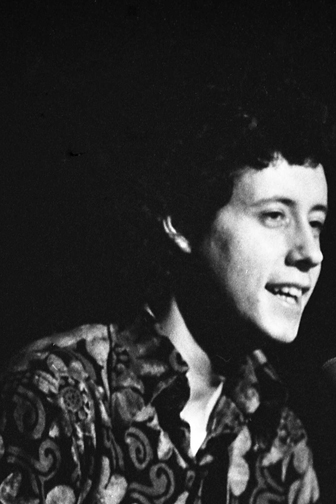
Photo copyright Mike Barich
Peter Vaughan’s review for the Star said that Arlo was a much better storyteller than a singer, proven by his two monologues, peppered with words like “groovy,” “weird,” “man,” and “way out.”
INCREDIBLE STRING BAND
The Incredible String Band performed on November 30, 1969, presented by the Walker.
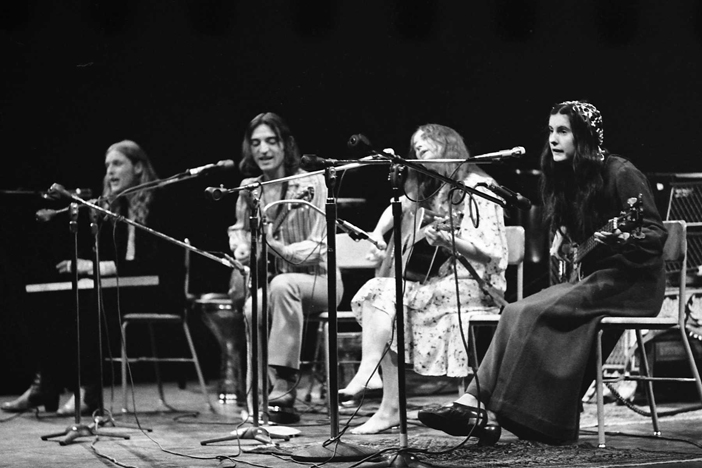
Photo copyright Mike Barich
The band’s members were Robin Williamson and Mike Heron, two men from Scotland, and two young women identified only as Rose and Licorice.
Allan Holbert of the Tribune had a hard time thinking of something good to write in his review of this performance. They were having trouble with their sound system, making it impossible to hear the words to their songs. Plus he found the level of musicianship very low. The review was pretty harsh:
The band’s members don’t play in tune (in spite of the fact that they take years and ears to tune up). They do not play well together. None of them has much technical ability. Their songs are long, cutesy-folksy and repetitious.
Holbert described how, after each song, they all got up and changed instruments. The musical high point, he said, was Williamson’s graphic description of how pigs make love…
Tony Glover’s review in the Star disagreed with some of Holbert’s assertions. He wrote that the members were all highly accomplished technicians on the the amazing array of instruments they played: guitar, sitar, mandolin, bass, organ, violin, hammer dulcimer, gimbri, and various flutes. Glover wrote that most of the material was original, with words by Williamson and music by Heron.
1970
SAM & DAVE
Sam Moore and Dave Prater came with their 3 Act Soul Revue on February 15, 1970, presented by the Walker. The theater was only a little more than two-thirds full.
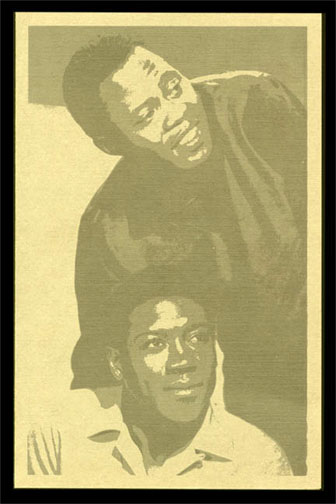
Program cover courtesy Walker Art Center
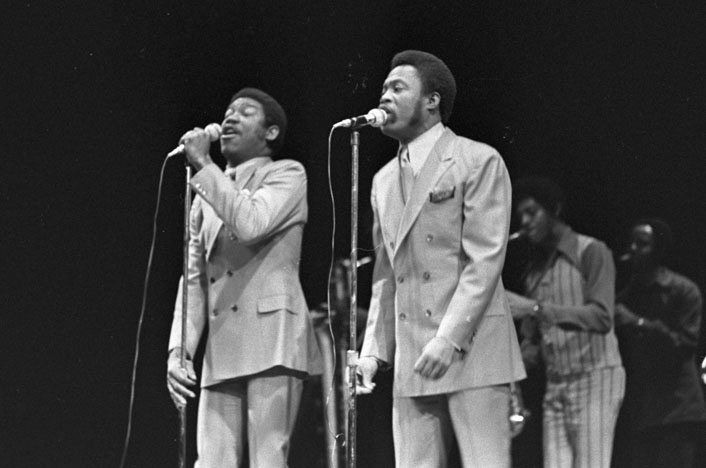
Photo copyright Mike Barich
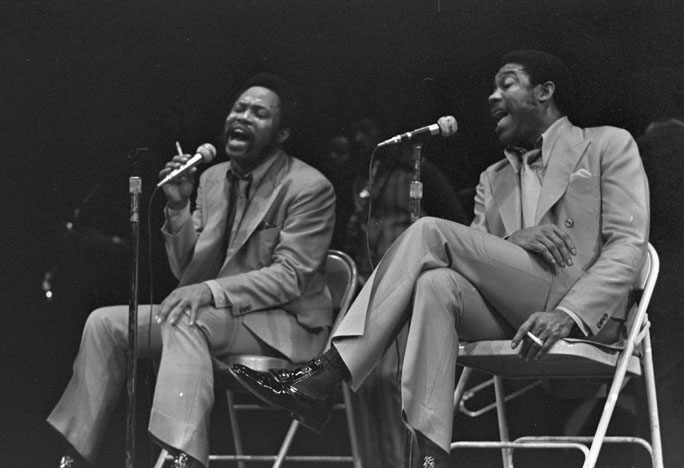
Photo copyright Mike Barich
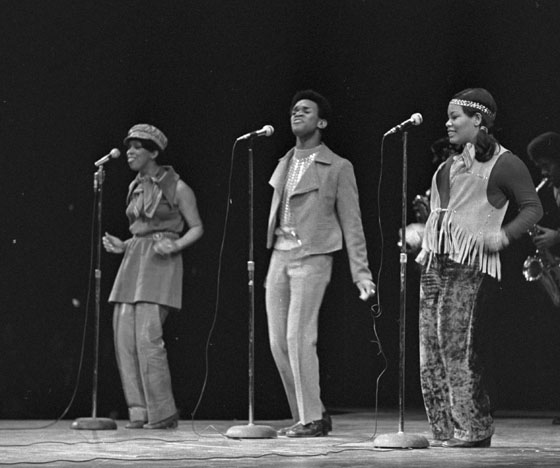
Photo copyright Mike Barich
Allan Holbert of the Tribune found the show to be a “deliciously entertaining” evening of music, theater, and dance. The band, called the Soul Men, was made up of four saxes, two trumpets, two trombones, two electric guitars, two drummers, and an organ.
One prescient last remark on the part of Holbert was, “I hope someone brings them back to town before they become so expensive that no one around here can afford them.” Just four months later, Sam and Dave split up for the first time, until 1971.
THE BAND
The Band, opened by Robert Pete Williams and Rev. Robert Wilkins, performed two sold-out shows on March 22, 1970, presented by the Walker. About 200 people had to be turned away for each show.
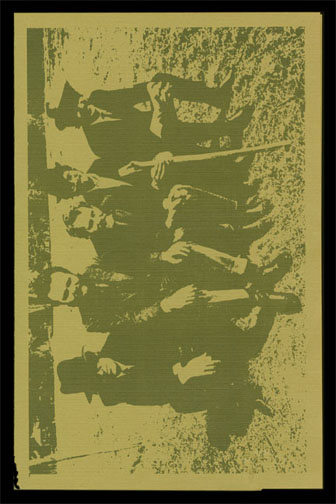
Program cover courtesy Walker Art Center
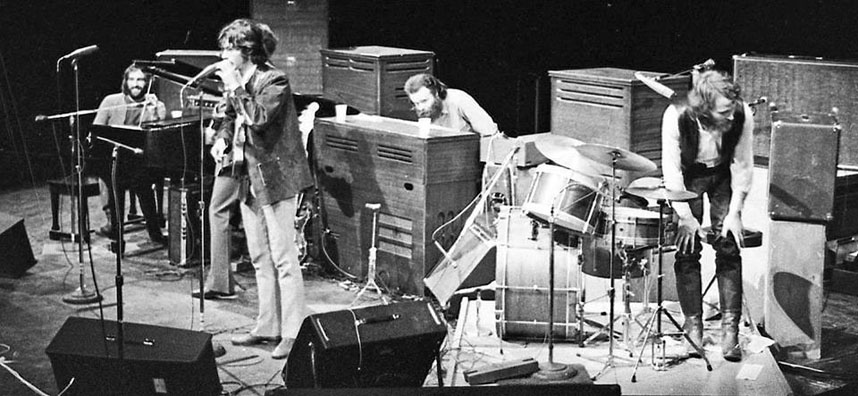
Photo copyright Mike Barich
Allan Holbert of the Tribune reported that the first show started about an hour late, and put on one of the best rock concerts that’s happened since the Walker changed Jazz at the Guthrie to Rock at the Guthrie.
Ray Olson in the Minnesota Daily reported that the group played 18 songs and two encores, with the second show starting at 11 pm. There was no posing or posturing – they just picked up their instruments and played. 1970 was a big year for the Band, with many hit songs already recorded and well known. When the Band strolled offstage at the end of the show, the audience, which had already risen several times during the show, went wild, stood as one, cheering, whistling, and stomping. They returned, exhausted after two shows. Johnny Winter appeared in the wings, after his show at the Labor Temple earlier that night. Richard Manual tore into Little Richard’s “Slippin’ and a-Slidin'” – Winter did not join in. A second encore was demanded and received: The Four Tops’ “Loving You is Sweeter Than Ever.”
Williams and Wilkins
Opening the Band’s show were Robert Pete Williams and Rev. Robert Wilkins. Holbert wrote that Mr. Wilkins did all of his songs on the same chord, and Williams played some gutsy blues. “Neither was very impressive, but they were both funky.”
GORDON LIGHTFOOT
Gordon Lightfoot performed on May 17, 1970, presented by the Walker. The show was sold out. This was Lightfoot’s first appearance in the Twin Cities
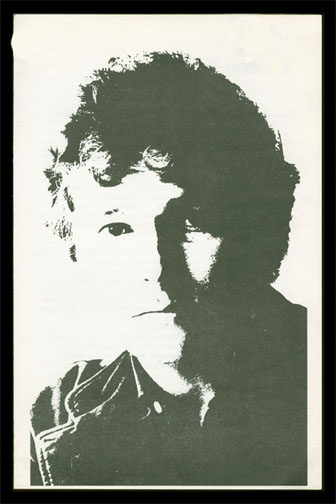
Program cover courtesy Walker Art Center
Mike Steele of the Minneapolis Tribune (May 18, 1970) called his work “direct, low key, lyrical and melodic, but still gutty.” The audience was extremely responsive, even though he was “undynamic yet somehow effective… talking very little and singing a great deal.”
Onstage with him were an unnamed bass player and lead guitar player. Songs included
- Did She Mention My Name?
- Waiting for Doomsday to Come
- Early Morning Rain
Hundred Flowers reviewer Harold E. Pipestem, Jr. (that’s what it says) was thoroughly impressed and entertained by Lightfoot, who played to the audience.
PENTANGLE
The Pentangle performed on June 7, 1970, presented by the Walker. About 700 people attended.
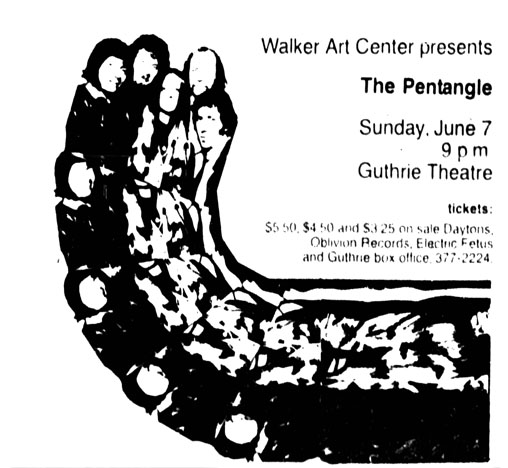
Minneapolis Tribune, May 1970
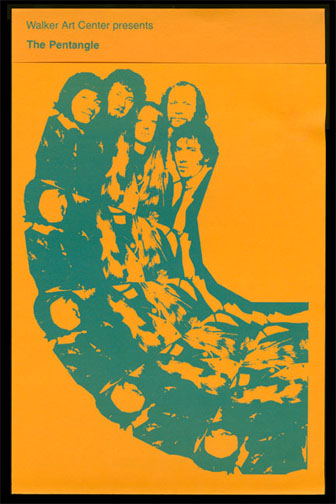
Program cover courtesy Walker Art Center
Pentagle was a London-based band that blended folk, blues, jazz, and rock, according to Tribune reviewer Scott Bartell. Members were John Renbourn on guitar and sitar, Bert Jansch on guitar and banjo, Danny Thompson on string bass, Terry Cox on drums, and Jacqui McShee on vocals.
Peter Altman of the Star wrote that they played almost unamplified, and that Jacqui McShea’s voice was used more as a fifth instrument. Pieces included an adaptation of a Bach sarabande for guitar and zither, English and American folk songs such as “The Ballad of the House Carpenter” and “Will the Circle be Unbroken?,” Indian-flavored selections, a comic version of Thelonius Monk’s “Blue Monk,” and several numbers that might be labeled contemporary art-songs in a pop vein. In all, he said, their music was eclectic pop chamber music, and really exceptionally invigorating.
JAMES TAYLOR
James Taylor performed on June 21, 1970, to a packed house. The show was sponsored by the Walker.
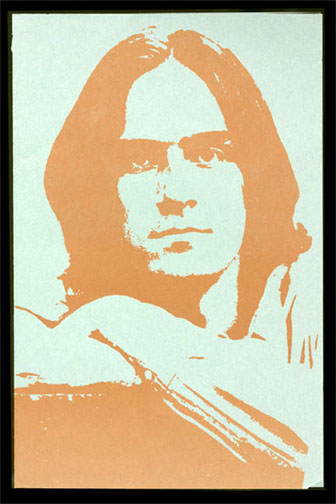
Program cover courtesy Walker Art Center
Tribune reviewer Scott Bartell wrote that the first song in the concert was “A Little Help From my Friends.” Taylor played for two hours and did two encores, which were fragments of songs that he has recently written, so his last real work of the evening was “Sweet Baby James.”
FRANK ZAPPA
Frank Zappa and the Mothers of Invention, with Flo and Eddie, performed two shows on July 5, 1970, presented by the Walker. The theater wasn’t more than half full.
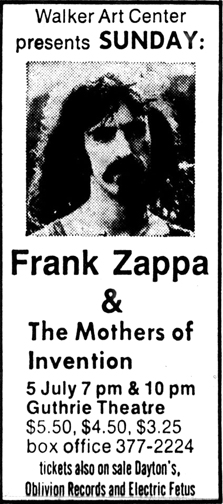
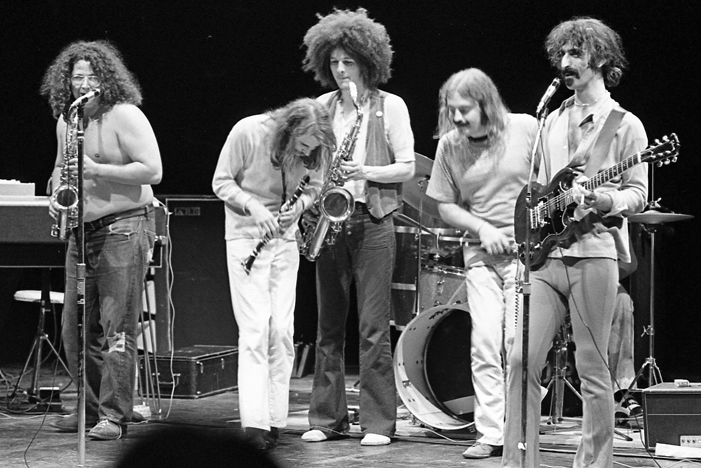
Photo courtesy Mark Peterson
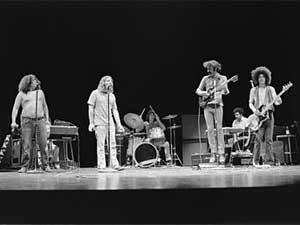
Photo by Tom Berthiaume
Jim Gillespie of the Star wrote:
It was totally bizarre from the beginning. Instead of handing out programs, the ushers passed out plastic cylinders with 14 air bubbles covering the surface. Upon being squeezed – and all of them were – the bubbles popped. Waiting for the show to begin had the effect of being caught in a fire-fight in Cambodia.
Gillespie wrote that the group had only one horn man now, Ian Underwood, who played electric piano most of the time. Their vocals had improved tremendously, perhaps with the addition of Flo and Eddie, who he did not mention.
Thomas Utne of Hundred Flowers noted that this was the second appearance at the Guthrie for Zappa in a year and the last on a three week road tour. He also noted that the Mothers played almost completely different sets for the two shows that night.
Gary Gimmestad remembers:
“it was “truly one of the greatest rock shows ever. The programs for the show were printed on bubble wrap and the effect of the audience randomly popping them was great! The warm-up was a magician who made birds appear and disappear (a local guy I think) and two springboard acrobats. I don’t know if this was Zappa’s idea or not but it was brilliant. Zappa’s guitar skills were clearly evident (much more so than on recordings) and the band was killer. It ended with “Happy Together” – Flo and Eddie were shirtless with banana peels dangling from their waists.
Another memory that has lasted 50 years: “If I remember correctly, Frank came out picking his nose and flicking boogers at the audience.”
Shan Lines tells us: “Portions of this show ended up on the album ‘Chunga’s Revenge.’ The entire performance (both shows) was released in 2016 as part of the Road Tapes series.”
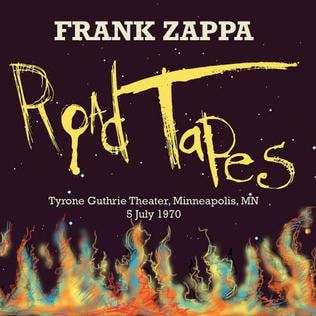
Opening Act?
Gillespie gave no name to the opening act, a team of acrobats cavorting around the stage, and a magician who pulled about nine doves out of the air. More acrobats followed. Or maybe this was just part of Zappa’s madness.
JOHN DENVER
On August 9, 1970, John Denver gave a benefit performance at the Guthrie to an overflow crowd. Proceeds went toward the People’s Commission of Inquiry, a group of 32 Minnesotans who went to Paris in June 1970 to talk to negotiators and discover what terms were needed in the Far East. Tickets were $3.50 and the event was organized by the Newman Center. (Minneapolis Tribune, August 2, 1970).
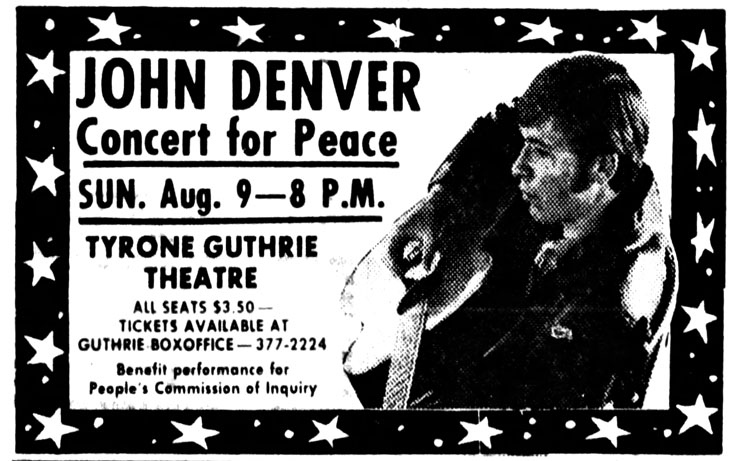
Kristen Bachler reviewed the concert for the Star, and said that Denver sometimes seemed like he became overly emotional during a song, but never insincere. She reported that Denver tried to get the audience united and actively involved by using sing-alongs, which usually didn’t work in Minnesota, but this time it went over. In all, she called the concert a masterpiece.
HOMEGROWN
Homegrown was a showcase for local artists that took place at the Guthrie on August 23, 1970. It started at 4 pm and ended at 10. The show was presented by the Walker.
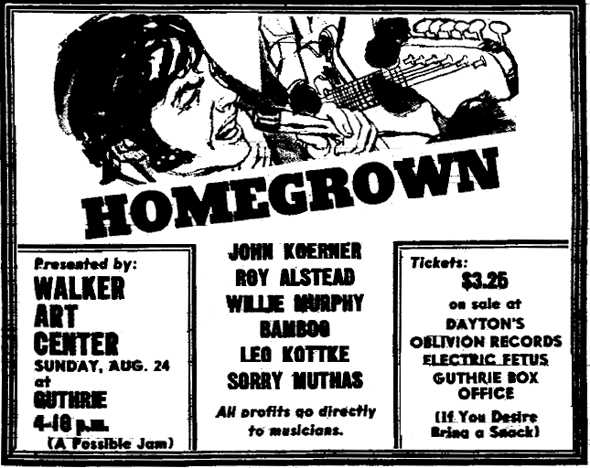
Minnesota Daily ad courtesy Robb Henry
The first performer was Ray Alstead, who played acoustic and electric guitar, and a little bit of “railroad humming harp,” and was “magnificent,” according to reviewer Betty Boop of Hundred Flowers. Kristen Bachler, reviewing for the Star, wrote that Altsead plays guitar and harp in a jazzy-bluesy way reminiscent of John Mayall and does it extremely well.
Bamboo was made up of Dave Ray on electric guitar, Will Dunicht on bass, Danny Hall on piano, and Jeremy Hall on drums. Bachler deemed them somewhere between blues and rock, never combining the two satisfactorily. Betty wrote that they had some trouble with amps and arrangements, but they still put on a “pretty good show.” Scott Bartell, reviewing for the Tribune, found the group to be a little bit sloppy but left the house happy.
John Koerner started by saying “Well, here we are at the Triangle Bar.” Betty’s description sounded like Koerner’s routine was more comedy than music.
Next came Willie Murphy and his new blues band, in their first performance together. It was made up of Wee Willie Walker, Russ Hagen, John Beach, Voyle Harris, Gene Hoffman, and Kenny Horst. Bachler opined that this group did not meet the standards set by the other performers. They were disorganized and although each musician was fine on his own, they made little attempt at unity. The vocals of the blues-oriented soul were drowned out by the instruments. Bartell wrote that the band’s rhythm and blues approach with hard-edged jazz horn breaks lost at least half the audience.
Leo Kottke was given the only standing ovation for his work on 12-string guitar and dobro. From blues to Bach “he did us right,” wrote Ms. Boop. Bachler agreed, calling his the most outstanding performance of the evening. She said he was not only a fine technician but an excellent interpreter and his music was sensitively as well as brilliantly executed. Bartell noted that most of his offerings were instrumentals, broken up by whimsical monologues.
The Sorry Muthas were last, with members Papa John Kolstad, Bob Stelnicki, Cal Hand, Bill Hinkley and Judy Larson. Betty Boop wrote that their good back-porch juggers had gone electric washtub. They fiddled and spooned and played themselves into “We Shall Not be Moved” with some of that good ol’ country music. Bachler called their music smooth, polished, and lighthearted. She also wrote that that they played an exceptionally long and varied set which had the audience craving more of the good-time music they do so well.
LEON RUSSELL
Leon Russell performed on September 6, 1970, in a concert presented by the Walker.
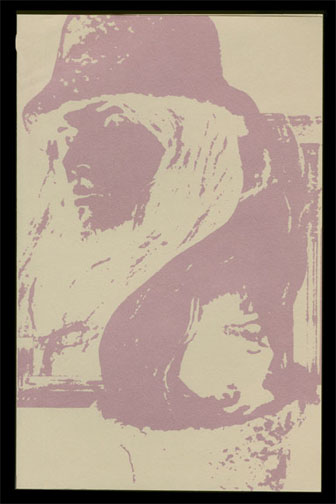
Program cover courtesy Walker Art Center
Star reviewer Dodd Lamberton reported that Russell began the concert alone on the piano singing four numbers. He was then joined by his band, which was made up of Chuck Blackwell on drums, John Gallie and Don Preston on guitars, Joe Cooper on Organ and bass piano, and Claudia Lanier and Kathy McDonald on Vocals.
The crowd gave Russell three standing ovations. Hundred Flowers groused that it was no complement for the musician to be dragged back for encores after they’ve been knocking themselves out for two hours.
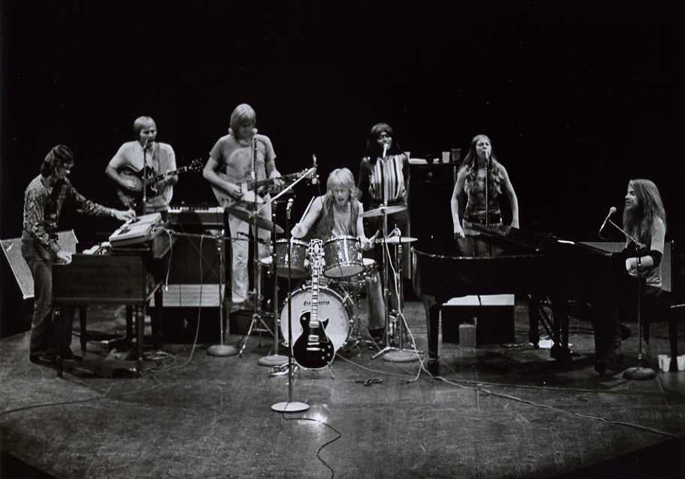
Photo copyright Mike Barich
YOUNGBLOODS
The Youngbloods appeared on September 20, 1970, presented by the Walker.
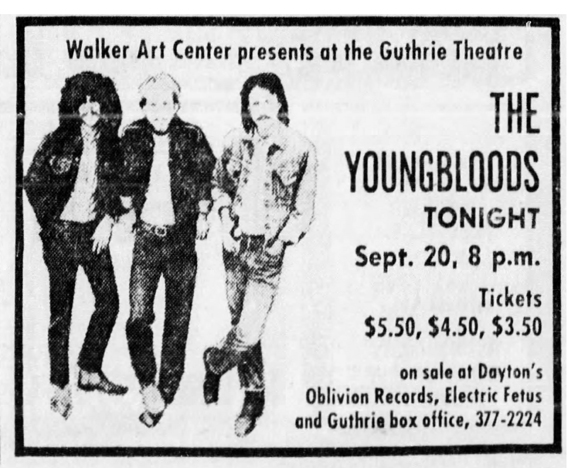
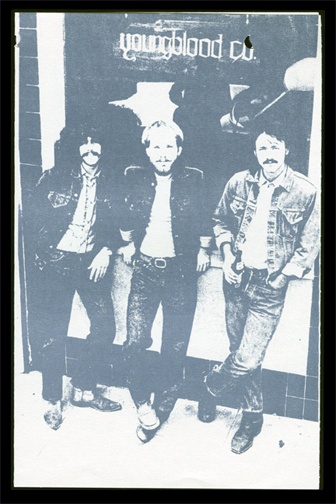
Program cover courtesy Walker Art Center
Dodd Lamberton of the Star found this concert to be a disappointment: despite the group’s obvious lack of enthusiasm, the audience loved them and clapped and stomped and made them play three encores. The show started off well with “Sunlight,” a mellow piece, but a perceived lack of response from the audience made them turn to the blues, which triggered a rush to the stage, which Lamberton thought to be unprofessional.
Hundred Flowers counted SIX encores, and concurred that the audience was rather stiff for most of the concert. The unnamed reviewer said that lead singer Jesse Colin-Young pleaded for the audience to dance, but it wasn’t until they played an old rocker that the audience got to its feet. It was deemed a “contrived but super-happening.”
LEONARD COHEN – NO EVIDENCE
Leonard Cohen appears in a couple places, appearing on November 11, 1970, presented by the Walker. There is no evidence in the Minneapolis Star or Tribune that this ever happened. However, a look in the program file yields no evidence that it didn’t happen. The only unusual thing was a rider to the contract that there be no other act on the bill.
GRATEFUL DEAD
The Grateful Dead gave two shows on October 18, 1970, presented by the Walker. Both shows were sold out well in advance.
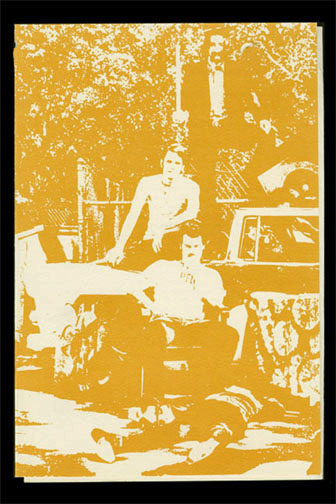
Program cover courtesy Walker Art Center
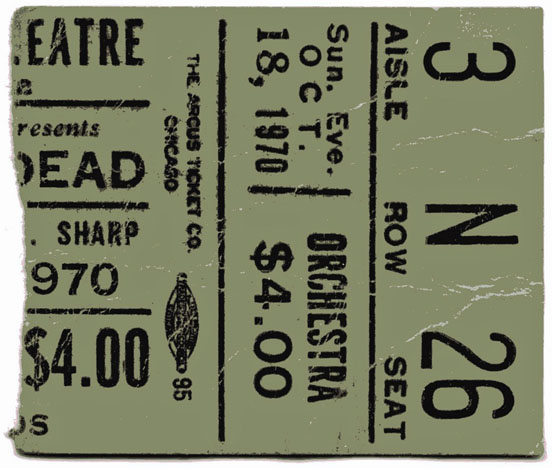
Grateful Dead ticket stub courtesy Robert Borchert
Jim Gillespie, reviewing for the Star, wrote that the Dead “tore the place apart with their patented mixture of rhythm and blues, screaming hard rock and modern country and western.” They opened with “Casey Jones” with Jerry Garcia singing lead and Bob Weir providing vocal support. Weir handled the more country-oriented material. There were two extended jams on “Morning Dew” and “Good Lovin.'” Gillespie was disappointed that they didn’t do any acoustic numbers with Garcia playing the pedal steel guitar, but it was a fine night of music.
The reviews mentioned other songs performed:
- Mama Tried (by Merle Haggard)
- Me and My Uncle (by John Phillips)
- Cumberland Blues
- Uncle John’s Band
Scott Bartell of the Tribune reported that the audience for the first show nearly refused to leave the theater for the audience for ticketholders for the second show until they got an encore. “They did not get it, and they sludged out with many childish and rude words flung at the stage.”
Henry Staten reviewed both shows for Hundred Flowers. He wrote that the first show wasn’t too exciting, but the second was fantastic; “the whole house was standing, shaking, stomping, and having the kind of totally together experience that you always hope a rock concert will bring. This was one night you didn’t even have to be stoned to be turned on.”
Robert Borchert shares this remembrance of the concert with us:
Fifty years ago today, on a Sunday night, the Grateful Dead played at the old Guthrie
Theater in Minneapolis. My apartment mate Bill Buchen and I rode our bikes over to the
show from our place near the West Bank. We lived two blocks west of Seven Corners at
the intersection of Washington and I-35W – which was under construction at the time.
The dilapidated building stood in the shadow of the Minnesota Paints factory at a spot
which is now the parking lot for Bobby and Steve’s Auto World and a couple blocks from
the new Guthrie Theater.
There were two shows scheduled that night with separate tickets and like most
everybody else with any sense we had tickets for both shows. The Guthrie strictly
forbade, as they still do, the use of any recording equipment at their shows. The lack of
a ‘taper’ section and no ‘tapers’ at all were evident then and historically obvious now as
there seems to be no shared recordings of those shows. Even an accurate playlist is
missing and subject to subjective memories of attendees – all of whose memories of that
night are questionable.
Bill had a battery-powered cassette tape recorder strapped to his abdomen underneath
his heavy shirt. A wire ran from the recorder down his sleeve to a microphone at his
wrist. I can’t remember if it resulted in anything of quality or even historical interest but
it’s long gone now.
It was a few months after the release of “Workingman’s Dead” and a few weeks before
the release of “American Beauty.” My recollection is that the show was a synthesis of their standard extended improvisations (such as The Other One, Good Lovin,’ Dark Star) and some of their crisper cuts from the new albums augmented by their signature
wandering embellishments.
The crowd was enthusiastic but remained mostly seated and moving in place through
the first show. At the end of the first show folks stepped outside chatting and wowing,
many taking the opportunity to imbibe or re-dose the experience enhancing substance
of their choice. With the first song of the second show (China Cat I think?) the audience
exploded, dancing into and down the aisles.
The show ended on the second or third encore with Jerry Garcia coming out alone and
singing Uncle John’s Band a cappella and solo until the rest of the band drifted out and
joined him.
JOHN SEBASTIAN
John Sebastian performed on November 15, 1970, presented by the Walker. Podipto, a five-member group from Bemidji, was to have accompanied Sebastian but had a contractual difficulty.
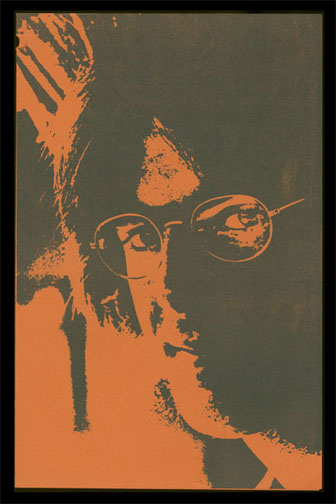
Program courtesy Walker Art Center
Jim Gillespie of the Star reported that Sebastian came solo, and promised not to leave until everyone had heard all the songs they wanted. He kept his word. Throughout the evening, members of the audience called out requests for their favorite songs, and he would pick one of his three guitars and sing it. For his talent and affability, Sebastian garnered three standing ovations and played two encores. For one of them he did harmonica solo that included every style from campfire on the prairie, to Chicago blues to Cajun dance music, all done perfectly. “Has the man no shame?” asked Gillespie.
ELTON JOHN
Elton John, with Podipto, performed on November 29, 1970, presented by the Walker. The theater was two thirds full.
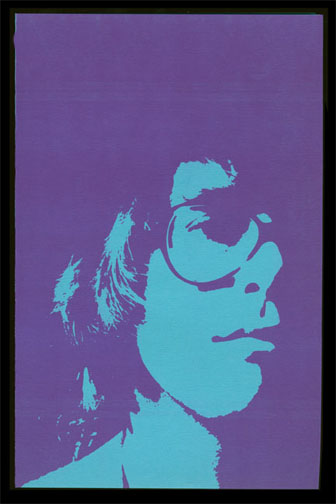
Program cover courtesy of the Walker Art Center
Elton John
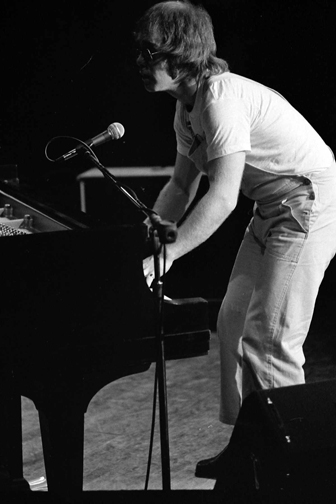
Photo copyright Mike Barich
This concert was a special matinee, arranged because of a play that was scheduled in the evening. It was scheduled to start at 2:30 pm. Tickets were a mere $4!
Tribune reviewer Scott Bartell wrote that his first two numbers were performed alone at the piano. After that he brought out Nigel Olsson on drums, and Dee Murray on electric bass. All of the songs performed were written by Elton John and Bernie Taupin except “Honky Tonk Woman.” During the song “Burn Down the Mission,” he kicked over his piano stool and got the audience screaming on their feet. He promised to come back in April and called them “the best audience.. and the best stage I’ve played in the U.S.”
Peter Altman of the Star saw right away that this was “an artist who will be a great star soon.” He had great versatility and skill and at first played very intricate, balanced arrangements. As the concert went on, they move away from the orderly and toward exciting, long, improvisatory rock numbers. In two fantastic final medleys, he kicked away his piano stool and attacked his keyboard from standing and prone positions, danced dionysiacally around the stage, incited the audience to sing and clap, and generally annihilated convention. He was sure that they were discovering a rare young artist.
The Insider reported that he wore a purple cape and yellow bib overalls with a decal of Donald Duck on them. Altman called this a disguise and chalked it up to shyness.
Podipto
Bartell wrote that Podipto was a five-member group from Bemidji who had recently released an album on GRT. They had appeared with James Taylor, and would have appeared with John Sebastian at the Guthrie the week before but for a contractual difficulty. Bartell found them to have a bright, fresh sound, a bit like Creedence. They sang all of their own compositions, which were quite pleasant, although the lyrics were rather simple-minded.
Altman also liked Podipto, calling them easygoing and sensitive, in the western or folk vein. The were no match for Elton John, but they were charming, and deserved to be heard from again.
DAT FEELIN’
This was a benefit for The Way Educational Center, a Community Center for North Side teens. It was presented on December 6, 1970.
40 Twin Cities area musicians participated in an original 2 1/2 hour production that traced the development of American music from slavery to psychedelics. The show was written by Milt Williams of the Black Studies Department at the University of Minnesota, and was produced and directed by Tom Tipton, a Minneapolis public relations and advertising executive. The Minnesota chapter of the Public Relations Society of America Sponsored the show.
The show was a sellout – 200 to 300 people were turned away at the door. And some of the more famous people in town who were in or at the show were mentioned in Margaret Morris’s gossip column in the Tribune. An estimated $10,000 was raised for The Way.
LEO KOTTKE
Leo Kottke had his first solo performance at the Guthrie on December 26, 1970, presented by the Walker.
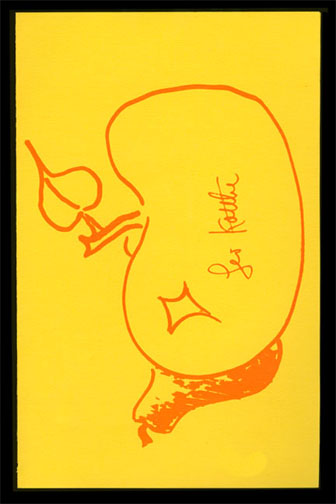
Program cover courtesy Walker Art Center
Tribune reviewer Scott Bartell reported that Kottke played 25 songs, starting with “Vaseline Machine Gun.” He only sang a few songs, and “his usually strong and emotional voice sounded a bit unsure and unsupported.” Bartell thought his between-song anecdotes and one-liners were even better than Arlo Guthrie’s. After a standing ovation he played an encore of “Watermelon” and “Turtle Hills.”
Jim Gillespie, reviewing for the Star, called Kottke an extraordinary guitarist and a genuinely soulful vocalist. He noted that Kottke was an absolute master of bottleneck playing. And his witty repartee between songs was just as funny as his music was masterful.
1971
NEIL YOUNG
Neil Young, with John Hammond, performed on January 14, 1971, presented by the Walker.
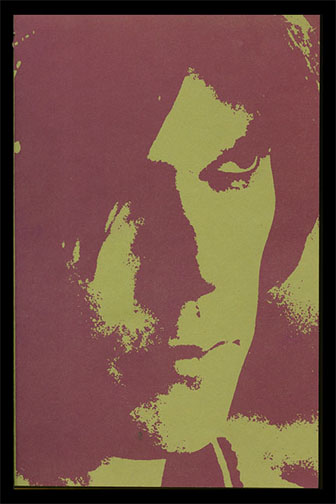
Program cover courtesy Walker Art Center
This was the first concert that the subject of ticket scalping came up. Tribune reviewer Mike Steele reminded us that less than a year ago, a Crosby, Stills, Nash, and Young concert was boycotted and cancelled for its high ticket prices. This time, for a solo concert by Young, the concert was sold out within two hours after they went on sale, with no advertising. Suzanne Weil of the Walker sent the tickets over to Dayton’s (the only ticket outlet while the Walker was under construction) on December 31, 1970, with instructions to sell them on January 2, 1971. Word of mouth did the rest, and they were gone.
Weil had asked Young to do two concerts, but he wanted one, long intimate evening. He felt bad about the boycott and wanted to give a good concert here. He took a lot less money to perform at the Guthrie, a relatively small house. Weil said she felt bad that so few people could get to hear him. She wasn’t worried about scalpers, but she was a little concerned about people without tickets showing up and having to hire security.
Peter Altman of the Star noted that Young’s songs evoked few bursts of applause, but the response to his total performance was exceptionally strong and generous. He only played 12 songs, but he had a cold and had slipped a disc three weeks ago, so he was a bit fragile. He alternated between piano and guitar, playing familiar songs and new material.
Two years later, Marshall Fine mentioned this Guthrie concert when reviewing another Neil Young concert, held in the Met Sports Center in 1973. He wrote that even though the Guthrie concert was only 45 minutes long, “the audience left awed and touched by the beauty and intensity of Young’s performance. It was possibly the most intense concert stage in Minneapolis until the Rolling Stones’ appearance in 1972.” (Minneapolis Star, January 8, 1973)
John Hammond
Scott Bartell of the Tribune wrote that Barry Knight introduced Hammond, which the audience was apparently not expecting and grumbled about but ultimately approved.
Altman described Hammond as a white blues singer. His “show of skill and fluency in an adopted “authentic” style drew admiration, but little enthusiasm,” wrote Altman.
TAJ MAHAL
Taj Mahal performed on February 4, 1971, presented by the Walker. It was a sold-out show.
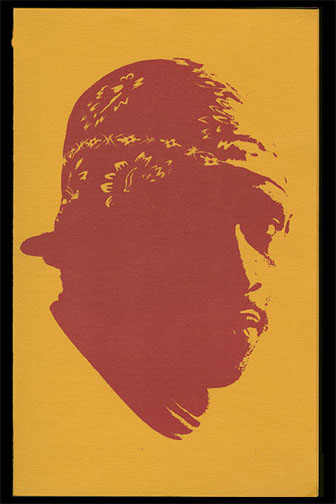
Program cover courtesy Walker Art Center
Scott Bartell reviewed the show for the Tribune. Mahal had a new band and Bartell thought he was a gas! There was a long delay to get in, with construction at the theater forcing everyone into the passageways while the sound system was being set up.
Mahal began on his ambira, a little African thumb piano. He launched into some blues, then did the song “Rollin’ Into Phoenix” solo on the five-string banjo. After his first half dozen songs he brought on his new band: John Simon on keyboards, John Hall on guitar, Grag Thomas on drums, and Bill Rich on bass. There was also a horn section of Howard Johnson, Earl McIntyre, Bob Stewart and Joe Daley. This was a special horn section were made up of flugelhorn, valve trombone, bass trombone, E-flat tuba, double B-flat tuba, and sax or trumpet. Bartell wrote that the four tubas used on “Sweet Mama Genise” could get overwhelming, they were always completely under control. They used the tubas again with “Big Kneed Gal Blues,” as subtly as a French horn quartet.
After 13 songs Mahal and his band left the stage, but the “wildly approving crowd made them come back and do their new ‘Divin’ Duck Blues.'”
The unnamed reviewer in Hundred Flowers wrote that in the first set when Mahal was by himself,
he told us in his slow, steady voice how he grew up in the South, and how he got into music because he felt that blacks were becoming Americanised faster than we were ready to, and we were leaving some of the best parts of our African heritage lost in the past.
He or she wrote that
the band looked like a cross between heavy Black Panthers and hard core freaks. The black men in the brass section were dressed in leather and tweed; the white electric rhythm section was very informal in blue jeans and old shirts.
FRIENDS OF FRITZ
No, this wasn’t a benefit for Theodore “Fritz” Mondale, but a gathering of musicians playing for a seriously ill fellow musician.
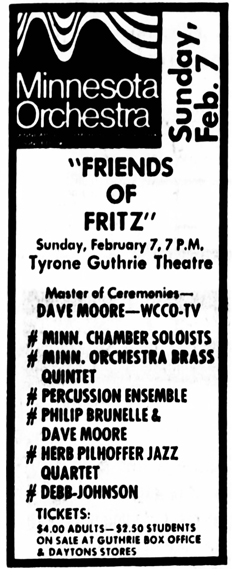
Minneapolis Star, February 1971
The concert has in honor of Frederick “Fritz” Scheurer, who had been a bass player for the Minnesota Orchestra since 1949. He had had both kidneys removed, had undergone two unsuccessful kidney transplants, and required treatment with an artificial kidney machine three times a week.
Included were performances by the:
Minnesota Chamber soloists:
Violins:
-
- Ronald Balazs
- Ruben Gonzalez
- Carl Nashan
- Richard Boberts
- Kensley Rosen
- Nancy Rosen
Violas:
-
- Gaetano Molieri
- John Tartaglia
Cellos:
-
- Stanley Atkins
- Robert Jamieson
Double Bass: James L. Clute
Harpsichord and bass: Robert F. Chickering
Minnesota Orchestra Brass Quintet:
- Ronald Hasselman, Trumpet
- David Kamminga, French horn
- Ronald Ricketts, Trombone
- Clement Volpe, Trumpet
- Stephen Zellmer, Trombone
A Percussion ensemble from the Minnesota Orchestra:
- Paula Culp
- Marvin Dahlgren
- Elliot Fine
Herb Pilhofer’s Jazz Quartet:
- Herb Pilhofer, piano
- Jay Goetting, bass
- Dave Karr, flute and saxophone
- Marvin Dahlgren, drums
Debb Johnson, a jazz-rock group:
- Bill Armstrong, guitar
- Bill Barber, piano and trumpet
- Doug Bronson, trumpet
- Glen Davis, trumpet
- Peter Enblom, trombone
- Jim Johnson, bass
- Peter Johnson, drums
Dave Moore of WCCO-TV was master of ceremoies and joined with Minnesota Orchestra pianist Philip Brunelle in a performance of Poulene’s “Fairy Tales of Babar the Elephant for Piano and Speaker.”
BEEFHEART – COODER
Captain Beefheart and his Magic Band, opened by Ry Cooder, performed on February 11, 1971, presented by the Walker.
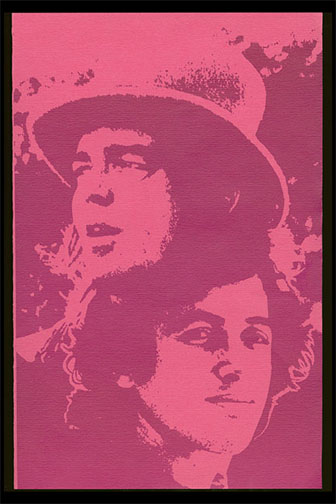
Program cover courtesy Walker Art Center
Captain Beefheart
Peter Altman of the Star reported that of the original 1,000 in the audience, about 100 walked out, and he wished he could have been one of them. His review was harsh: There was no evidence that Beefheart’s egotistic, deranged formula could produce appealing identity or intelligent musical style. He encouraged the members of the band, who wisely went under aliases, to look for jobs with other groups as soon as possible. Numbers were interminable and disorganized. There was no attempt to express feelings and no dialogue between players. It was impossile to understand what Beefheart was singing. And the way Beefheart kept blasting his horn into a microphone, causing screeces and distortions was excruciating.
Scott Bartell of the Tribune found the show “hard to evaluate.” He described how each member of the band entered the stage individually, each with some schtick and costume. One of the fans in the front row shouted to the scoffers, “if you don’t dig it, you can leave!” and many did, as noted above. “It may be that Captain Beefheart is in many ways holding up a mirror to an absurd world but I don’t find his vision very moving or exciting; occasionally, it was good theater.”
Richard Paske was at this concert and remembered this about Captain Beefheart’s performance almost 50 years later:
He put the bell of his soprano directly over the mic and made sounds never dreamed of by Bechet, Lacy, or ‘trane. The bass player, sporting a stache microns-thin that curved in huge loops extending at least a foot from his face, played nothing but double-stops the entire gig on his steer-horned Danelectro. Memorable!
Ry Cooder
In contrast to the Beefheart debacle, Altman found Cooder’s set very appealing and Cooder a gifted guitar player. He performed a set of traditional blues songs, about half the time playing mandolin, electric and acoustic guitars. On other songs he was joined by Steve Ferguson on on piano and a bass player and drummer. This was Cooder’s first time in the area, and he was deemed a musician of taste, lyrical sensitivity and charm. Altman said it was too early to tell whether he would become a star.
IAN AND SYLVIA
Ian Tyson and Sylvia Fricker performed on February 28, 1971, presented by the Walker. The house was nearly full. This was their second show at the Guthrie.
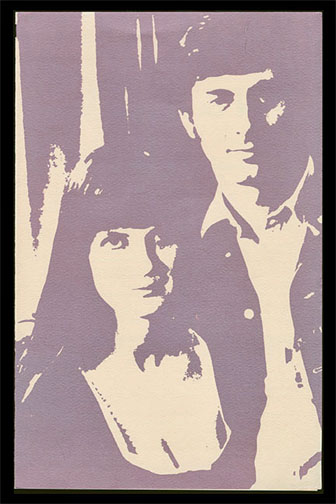
Program cover courtesy Walker Art Center
The Tribune’s Scott Bartell wrote that Ian had a cold, and that they were accompanied by guitar player David Wilcox. They performed over 20 songs, but seemed to lose energy in the second half of the show. After their first encore, Ian left the stage and let Sylvia finish with a sort of down song about an addicted youth, and the evening just sort of faded out.
Peter Altman’s review for the Star was very different. He wrote that the concert started out badly but suddenly turned around and after two encores the crowd went home highly pleased.
GORDON LIGHTFOOT
Gordon Lightfoot performed on March 7, 1971, presented by the Walker.
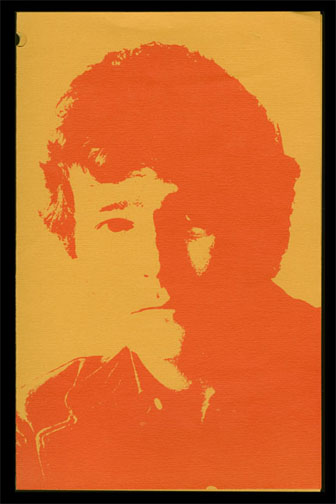
Program cover courtesy Walker Art Center
This was Lightfoot’s second concert in less than a year at the Guthrie. Reviewer Jim Gillespie of the Minneapolis Star (March 8, 1971) called him a “charming performer with a warm, intimate stage presence and a good sence of humor.” He played six and twelve-string guitars, and was accompanied by Rick Haynes on electric bass and Red Shea on acoustic lead guitar.
Songs played included:
- Did She Mention My Name? (Opener)
- Boss Man
- Bitter Green
- Ribbon of Darkness
- The Canadian Railroad Trilogy
- The Auctioneer
- Ten Degrees and Getting Colder
Gillespie wrote that he got a standing ovation at the end of the concert and that he deserved it.
Scott Bartell of the Minneapolis Tribune (March 9, 1971) was highly complimentary of sidemen Shea and Haynes. He reported that Lightfoot presented a mixture of old and new songs, including:
- If You Could Read My Mind, currently popular at the time
- Me and Bobbie McGee
- Come to the Door
- Home From the Forest
- Pony Man
Bartell did have this beef:
Though his singing and playing (and that of his accompanists) were spirited, his sensitive lyrics were the best thing about the concert. His double-takes and wisecracks, however, got a bit tiresome and seemed unnecessary, sometimes coming in the middle of an otherwise serious song, breaking the mood Perhaps he has retained to many of his techniques for drowning out the “beer-bottle symphony” learned while he was playing in bars.
MILES DAVIS
Miles Davis performed two shows on March 19, 1971, presented by the Walker.
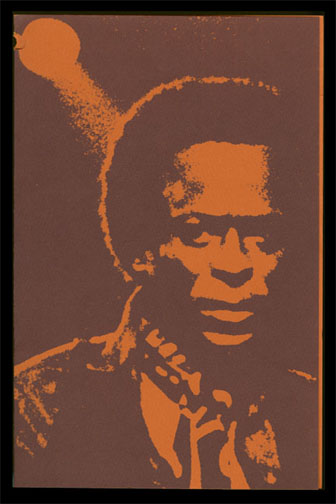
Program cover courtesy Walker Art Center
Jim Gillespie of the Star reported that Michael Henderson had been scheduled to play bass, but was stuck in a holding pattern over Chicago, so Keith Jarret covered by playing the bass octave of his electric organ with one hand while providing intricate accompaniments and solo work on the electric piano with the other. Gillespie deemed it a most impressive display of virtuosity. Other band members were Gary Bartz on alto and tenor saxophones, Airto Morierea on Latin percussion, and Jack DeJohnette on drums.
Miles, of course, was Miles, prowling about the stage in his buckskin pants, never smiling, picking up his hor to blow just the right note at the right time. His high-heel booted foot came down on the wah-wah pedal to produce sounds I’ve never heard come out of a trumpet before.
Gillespie reported that the concert lasted only an hour and 15 minutes but it was enough. It was either one long piece or several short pieces woven together – the music never stopped. Not all of it worked, but when it did, it was “some of the most exciting and moving music ever heard in the Guthrie.”
Richard Paske wrote the following piece on this concert and its aftermath in December, 2010. It is in the Walker archives, as well as in his three-part article commissioned by the Walker regarding all the concerts he heard there. The Miles piece is also on a Keith Jarrett website. It is reproduced here with his permission and thanks.
Miles at the Guthrie, 1971
March 19, 1971 is a night I’ll always remember. That night Miles Davis brought what some call his last great band to the Guthrie Theater in Minneapolis in two concerts presented by Walker Art Center. When I first got wind that these concerts were to take place – one at 7:30 PM, the other at 9 or 9:30 PM, I immediately reserved two tickets for the late show. Sometime later the piano player Tommy O’Donnell called me and asked me to play bass on a trio gig he had booked for a 10 PM opening party on the same night at what was then the Crawford-Livingston Theater in the old Science Museum building in downtown St. Paul. I agreed to take the gig but only if I could exchange my late-show tickets for early-show tickets. As fate would have it, tickets were available in the center section nearly in the front row! All of this happenstance led to my attendance at the early show and to one of the most indelible memories in my life as a listener.
First, a little background on the evolution of Miles’ sound – the sound of his band – in the months prior to the Guthrie concert. In the late summer and early fall of 1970, Miles’ working group had morphed into new form by replacing Steve Grossman with Gary Bartz on saxophone and losing keyboardist Chick Corea and bassist Dave Holland when they left to form their own band with drummer Barry Altschul and later, multi-instrumentalist Anthony Braxton. Continuing with Miles were Keith Jarrett on electric keyboards, Jack DeJohnette on drums, and Airto Moreira still contributing his other-worldly Brazilian percussion sounds. The most significant change came with Holland’s replacement – the R&B electric bassist Michael Henderson. At 19, a veteran of bands led by Stevie Wonder, Aretha Franklin, and Marvin Gaye, Henderson brought the Funk – the real Funk – that Miles had been seeking to get “…up in [his] music…” ever since he went electric in the late 1960s. This band – with the addition of John McLaughlin contributing soaring electric guitar lines – was represented on the LP Live/Evil. More recently the raw live recordings that led to Live/Evil were released on a 6-CD set The Cellar Door Sessions 1970.
For the 7:30 PM Guthrie show that night the hand of Mid-western Winter Fate intervened. Funkmaster Henderson was hung up over Chicago in a snowstorm so his flight didn’t arrive in time for the early show. I don’t recall if they announced his absence or not – with his usual stage reticence Miles sure didn’t say anything about it to the waiting audience. But here’s where my indelible musical memories of that night truly begin. Jarrett had his electric piano and electric organ set up in their usual wedge near the front of mid-stage right. (Jarrett’s reference to “…those pieces-of-shit electric toy instruments…” belie the absolutely amazing music he made with them on this night and on all of the recordings of this period). DeJohnette was further back on the stage in the center, with Airto on stage-left surrounded by his strange array of exotic sound-makers. Throughout the evening Bartz and Miles would walk from the far edge of the thrust stage-left each time they played melodies or took solos. Miles, of course, provided plenty of his trademark glares and scowls.
Once the music began, so did my immersion in it, courtesy primarily of Jarrett and DeJohnette. The two had much musical history together – famously on 1966’s Forest Flower: Charles Lloyd at Monterey – and their musical telepathy on this night reflected their total simpatico. I remember Miles, Bartz, and Airto as all performing with fiery passion and consummate skill, but it was Jarrett and DeJohnette who took me on a journey I’ll never forget. Because Henderson’s bass lines were missing, Jarrett had to step up and supply them, which he did with his left hand on electric organ. That left his right hand for comping and soloing on electric piano. Necessity being the mother of invention, Jarrett and DeJohnette became a rhythm section of three in two. Their history together and the circumstance in which they were placed allowed them to link themselves together into one musical mind for the entirety of the set. As I listened, I closed my eyes and was taken on a journey into deep consciousness as if I were a sea creature diving down, down, down into the depths of the ocean. As I dove down I lost all awareness of anything but the sounds that were carrying me. All verbiage disappeared from my mind. Jarrett and DeJohnette’s musical interplay became the only language in existence. Their instruments became one instrument, their musical voices one voice. As I was carried close to the bottom of this immersive sea of consciousness, literal thought would begin to creep back into my mind. I would hear myself thinking again as one does in normal daily life. I would begin to journey back up to the surface of normal consciousness. I would open my eyes and see Jarrett’s upper body rocking forward and back as he played just feet from where I sat. And then out of the blue KeithJack would play something so profound that I would close my eyes, reverse course, and continue my downward journey towards the depths once more. This process – down, a little bit up, down again – happened over and over again during the entire set of music. When it was all over I knew that I had heard music that came from the deepest fount of inspiration – perhaps even something eternal.
Well, you can imagine that the gig I played over in St. Paul at 10 PM that night was going to be unlike any other gig I had ever played in my life. Amplifying the mental state I was in were the states of pianist Tommy O’Donnell and drummer Dick Bortolucci who were both at the same early show. I remember that when I arrived at the gig with bass and amp in hand, Bortolucci and I could hardly contain ourselves as we tried to articulate in words what we had heard at the Guthrie. Borto told me that after arriving in downtown St. Paul he simply drove around in circles because he couldn’t get himself to get out of the car and carry his drums in for the gig. He, like I, didn’t want the experiences that we had just had to end, ever. Well, of course, the experiences did have to end and we did have a contract to fulfill. And man, did we ever! Tommy O’Donnell is legendary in the Twin Cities for his ability to bend traditional jazz standards into clouds of ethereal gossamer. That night, Tommy, Dick, and I did all that and more for the after-theater crowd in attendance. Inspired by Miles et al we couldn’t just play regular, standard B-flat party music. We stretched the boundaries of the normally acceptable into music that tried its best to pay homage to the music we had all heard earlier that night. That night was almost 40 years ago and I remember it like it was yesterday.
Coda I: Two nights later I heard the same Miles band as above with the addition of Michael Henderson on electric bass at a jazz club in Milwaukee. I remember the music as being very good, but not spectacular. After the experience I had had at the Guthrie it’s probably unfair to compare the two concerts, but it’s also unavoidable. Other than the unlikelihood of repeating the kind of peak experience I had at the Guthrie, there are probably two other reasons that the music didn’t soar to the same heights (or dive to the same depths). First, the jazz club environment didn’t create the same sense of cocoon-like intimacy afforded by the Guthrie Theater. (Ornette Coleman says that jazz clubs are about two things – booze and f*cking). Second, as skillful as Michael Henderson was as an electric bassist who was giving Miles just what he wanted, there’s no way he could compare to the consummate musical mastery of Keith Jarrett. Plus, he didn’t have as much history with DeJohnette as did Jarrett.
Coda II: I traveled to Europe that summer and ran into Gary Bartz outside the men’s room of Ronnie Scott’s in London. I engaged him in conversation about the Guthrie gig, thanking him profusely for his contributions to my magical musical evening. We then talked about Keith Jarrett and his unique musical genius. Words seemed to fail both of us.
JETHRO TULL
Jethro Tull, with Brethren, played two shows on April 1, 1971, presented by the Walker.
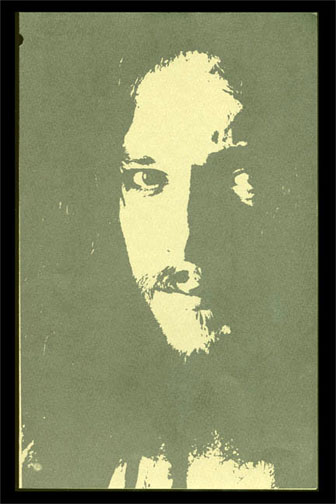
Program cover courtesy Walker Art Center
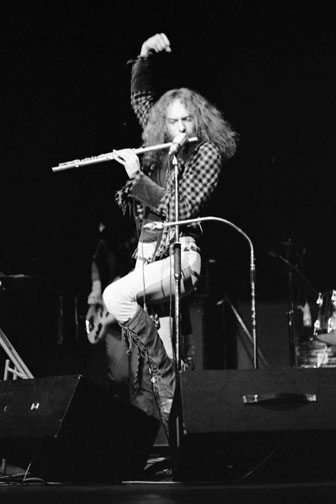
Photo of Ian Anderson copyright Mike Barich
The Program listed the members of the band as:
- Ian Anderson, who was described as leader, spokesman, dancer, composer, plays flute and multitudinous instruments.
- Clive Bunker, drums
- Martin Barre, lead guitar and occasional flute
- John Evan, piano and organ
- Jeffrey Hammond-Hammond, bass
Reviewer Scott Bartell, reviewing for the Tribune, called the group an amazing bunch, doing good theater on top of the music. They only did eight numbers, but they were all long and many-faceted, often making contrasting passages between quiet solos by Anderson and heavy ominous ensemble movements.
Jim Gillespie of the Star was impressed by the comedic dimensions of the group – the attire, mime and gestures. Unfortunately, the group’s musical abilities didn’t measure up to Anderson’s high-energy vaudeville, he wrote. And although all of the songs are original, they used the same basic formulas, and it began to get boring after a while.
Bretheren
Bartell wrote that this group was supposed to have a jazz-tinged Gospel sound, but only one man appeared, playing blues on acoustic guitar while screaming his head off. The drummer and pianist joined him for the fourth song. The Guitarist switched to electric, but was met with a dead amp, and was evidently so disheartened he just kind of left near the end of the last song, to be followed by the other two. “It was very sad.”
Gillespie explained that the group had lost its bass player, and had equipment trouble, but complimented the lead singer for his very strong blues voice and said they may develop into a first rate group.
DON ELLIS AND FRIENDS
Don Ellis and Friends played two shows on April 4, 1971, presented by the Walker.
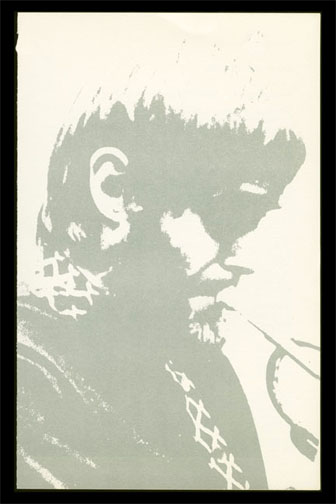
Program cover courtesy Walker Art Center
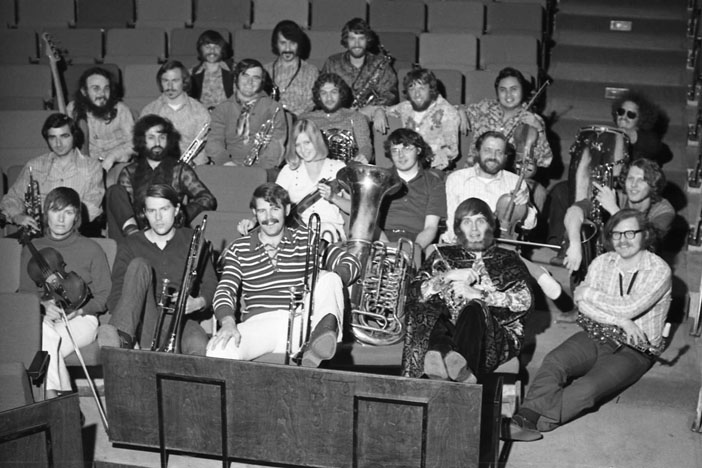
Don Ellis and Friends – Photo copyright Mike Barich
Don Ellis was a jazz trumpet player and drummer who was from Minneapolis. He had put together a big band of 21 players, including a string quartet, a woodwind quartet, a brass septet, three drummers, a pianist, and a bass player. Star reviewer Jim Gillespie wrote that the group played extremely well and the musicians were all talented. Most of their songs were in exotic time structures. During one song, Ellis worked with some electronic equipment which allowed him to play a duet with himself via delayed tape loop and used a distortion device to drop the sound of his horn to a booming bass. These effects were startling in 1971.
Tribune Reviewer Allan Holbert called Ellis’s music explosive and thoroughly unpredictable, saying that the group kept shifting from one musical bag to the next. While Gillespie praised Ellis’s trumpet playing but not his drumming, Holbert thought that he did a terrific job at either instrument. It was a one-of-a-kind band and a powerful evening of music.
Will Shapira reviewed the show for the Insider, calling it a heart-pumping set. It opened with “The Final Analysis,” which featured the band’s new pianist, Miltho Liviev, from Bulgaria. The second song was “How’s This for Openers?” in which the strings produced some weird, eerie, haunted-house music. Other tunes included “Euphoric Acid,” “Loss,” featuring an Ellis solo, “Ellis Is,” featuring the woodwinds, and the grand finale, “Strawberry Soup,” which ended in a “roaring, antiphonal crescendo as the band scattered all over the theater in small groups and tied it all together in a ribbon of funky blue.” After two hours and 15 minutes the audience wasn’t satisfied, so the group (Shapira counted 18 men and 2 women) presented a trimmed-down version of “Pussy Wiggle Stomp.”
ALLEN GINSBERG
Allen Ginsberg did a reading on April 14, 1971, presented by the Walker. HOWL????
John Greenwald started his review of this program for the Star by calling Ginsberg “a very strange guy.” He began his appearance with a Hindu chant, then sang songs by the English poet, William Blake, both accompanied on a harmonium, a small, accordion-like instrument shaped like a box. From there he moved to his own poems, chanted another mantra, and paused for intermission.
After the break he read more poems, sang more songs, and chanted more chants. A third session continued for those who wanted to stay, after five minutes of meditation in a cross-legged posture.
One of his poems, characterized by Greenwald as a long homsexual fantasy, was heard in absolute silence, then given a fit of applause. Afterward, Ginsberg told the audience that he was staying at the Gay Liberation Front’s Gay House while he was in town.
The review ended:
Ginsberg seemed at all times to want to be helpful. “And what’s the work?” he asked in an elegy to Jack Kerouac, a friend and fellow writer. “To ease the pain of living,” he said. “Everything else is drunken dumb show.”
VAN MORRISON – CANCELLED
This concert kept coming up on some lists but not others, never with a date. Finally a look at the file in the Walker Archives gives the potential date as April 18, 1971. A letter from Van’s management, signed by Mary Martin and dated February 18, 1971, reads:
It is with sincere regret that we have been forced to cancel all Van Morrison dates during the months of March and April due to the fact that Van’s band has disbanded. We hope that you will understad — we apologize for the inconvenience that we have caused. We have every intention of fulfilling our contracts and obligations to you in the future if you are able to fit Mr. Morrison into your schedule.
Looking at the personnel on his albums at that time verifies this. His album, “Van Morrison, His Band and the Street Choir,” was released on November 15, 1970, with a sparse band of six musicians and several singers.
His next album, “Tupelo Honey,” was released on October 15, 1971, essentially with the start of the Caledonia Soul Orchestra. This band was twice the size, with only three holdovers from the last album: Van’s wife Janet Planet (nee Janet Rigsbee); saxophone player Jack Schroer; and vocalist Ellen Schroer.
Can you imagine hearing Van Morrison in the intimate confines of the Guthrie?
He would first appear here on September 13, 1974, but it was at the Minneapolis Auditorium. Not the same thing at all.
LAURA NYRO
Laura Nyro, opened by Podipto, performed to two packed houses on April 25, 1971, presented by the Walker.
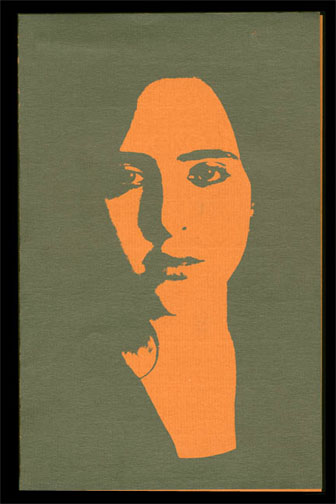
Program cover courtesy Walker Art Center
Tom Murtha reviewed the concert for the Insider:
Her voice was a little less restrained than on her records, but it was truly glorious in its honest lack of polish. The audience was completely enamored of her haunting intensity and modest demeanor. She returned twice to do a total of five encore songs, finishing up with one of her newest, “I am the Blues. These two concerts tonight have been like two wonderful parties,” she breathed before she left the stage.
Mike Anthony at the Tribune noted that, with the exception of Carole King’s “Up on the Roof,” all the songs she sang were her compositions, with lyrics of poetic sensibility and highly musical melodic lines. She sang with clear, rich tones that found trouble only in the upper register wher they occasionally turned a bit shrill. He wrote that she communicated best to women – and there were a lot of women at the Guthrie that night – for her songs are messages to women in rural and urban life.
KRIS KRISTOFFERSON
Kris Kristofferson performed on May 3, 1971, presented by the Walker.
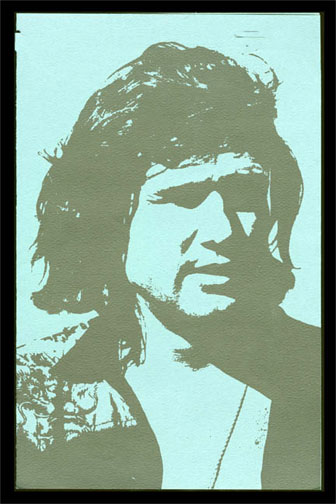
Program cover courtesy Walker Art Center
Star critic Peter Altman found Kristofferson so laconic that he was afraid the singer was going to fall asleep midsong. But despite the fact that he was not an exciting performer, he was a winning and strong one. Without any burts of showmanship or dynamism, he held most of the smallish audience rapt. Most of the songs he sang were his own compositions, without poetic pretense and devoid of emotional posturing and self-indulgence. He was backed by Donnie Fritz on organ, Billy Swan on bass, and Terry Paul on guitar.
ELP
Emerson, Lake & Palmer, with Mott the Hoople, performed on May 11, 1971, presented by the Walker.
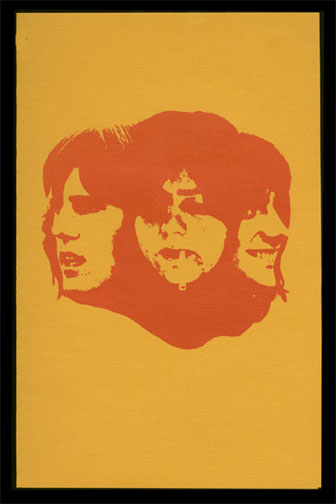
Program cover courtesy Walker Art Center
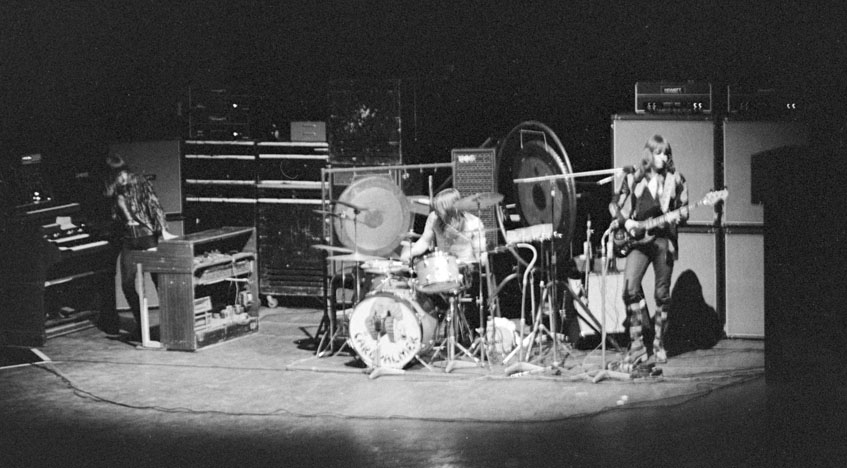
Emerson, Lake and Palmer – Photo Copyright Mike Barich
There doesn’t seem to be a review in the Minneapolis papers, but Michael Bjornberg saw the show and provided this review:
I am responding to the Mott the Hoople/Emerson Lake and Palmer show. I fully knew who both bands were and their reputations as rock bands. The audience was largely shaped by ELP’s first albums hits and light jazzy feel that is a more middle aged soft rock/jazz crowd.
Mott the Hoople warmed up. Mott came on strong and the soft rock crowd never knew what hit them. Minutes into the first song, 2/3 of the audience went back out into the lobby to wait for ELP. Then after they finished their set and a break, the crowd came back in for ELP.
ELP was getting good air play with Take a Pebble, Lucky Man and The Three Fates – appealing to a very different expectation for the show. If you had not known about Keith Emerson’s showmanship – well a surprise was waiting for the listener.
It started with Keith Emerson in a fur vest with no shirt and tight leather pants. He began to play the Hammond organ and his “Knives in the Keys” routine while riding the organ across the stage. It was not one of the three “popular” songs – likely “Barbarian” or “Knife Edge.”
That did it for the crowd again – a large group left for the night. Leaving the rest of us to enjoy what we came for.
Keith Emerson stabs knives in his Hammond-1971 – Bing video
I thought both bands put out great shows that night. I got exactly what I came for. Keith Emerson was in top form. The newspapers were not much into rock concert reviews at the time, as I recall, and even less inclined to review “unknown” bands.
That is how I saw the night.
JOHN MAYALL
John Mayall, with Randall’s Island, performed two shows on May 16, 1971, presented by the Walker.
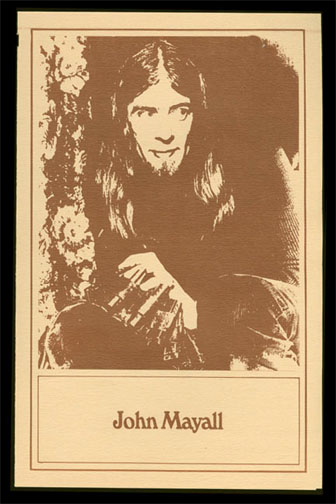
Program cover courtesy Walker Art Center
John Mayall
Jim Gillespie’s review in the Star reveals that Mayall’s current band consisted of Larry Taylor on bass, Harvey Mandel on guitar, Sugarcane Harris on electric violin, and Paul Lagos on drums. Mayall played guitar, keyboards, and harmonica, but in Gillespie’s opinion, none of them too well. Gillespie wrote that the group’s sound was not very cohesive, although Mayall did say that they were stretching out the songs because of the excellent acoustic qualities of the theater. Gillespie found Mayall’s voice all but inaudible and most of the music disappointing.
Randall’s Island
In Gillespie’s opinion, the opening act, a little-known band from New York, put on a far better show than the headliner. Led by Elliot Randall, a “wizard at distortion, on lead guitar, they played a loud but exciting set of original material. The high point was a pro-ecology song called “Oil on the Waters.” Gillespie had high praise for the band in the future.
LIVINGSTON TAYLOR
Livingston Taylor, with Dave Ray, performed on May 30, 1971, presented by the Walker. The audience numbered about 1,000.
Livingston Taylor
In Michael Anthony’s review for the Tribune, a lot of print was spent comparing Livingston with his more famous brother James. Livingston sang mostly songs from his album – about 20 songs in all – plus a few by Lennon & McCartney, Chuck Berry, and even “Over the Rainbow.” Gillespie found his stage manner to be a little “too cute,” but the audience loved him. He got a standing ovation and did several encores.
Peter Altman of the Star also compared Livingston to James, calling Livingston an extrovert who enjoyed giving a show. Wheras James weaves a delicate spell over his listeners, Livingston establishes a lively relationship with his hearers. He was supported by Walter Robinson on bass.
Dave Ray
Dave Ray played his usual impeccable guitar work, both acoustic and electric in a half-dozen blues and boogie numbers, reported Anthony.
Altman characterized Ray’s set as “instrumentally excellent if somewhat monotonous.”
TOM PAXTON
Tom Paxton, with Judee Sill, performed on June 13, 1971, presented by the Walker.
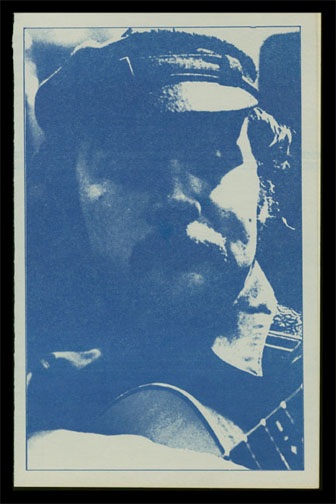
Program cover courtesy Walker Art Center
Tom Paxton
Peter Altman of the Minneapolis Star counted the house at about 800. Altman was disappointed with Paxton’s songs: “Musically, Paxton’s works were commonly marred by unfortunate effects. Emotionally, they were inconsistent and at times evasive. Verbally, they seemed to be skipping around pointlessly from idea to idea and not expressing essences.”
Michael Anthony at the Tribune found Paxton to be mellower in the ’70s, singing like a poet-minstrel, singing songs with deep feeling and melodic reichness and sensitivity. His sidemen were Herb Busher on bass and David Horowitz on piano.
Judee Sill
Altman reported that Judee Sill just started performing professionally in January 1971. The review was mixed; he had nothing good to say about her voice, and her lyrics were “poetic in adolescent ways,” “obscure,sometimes clumsily symbolic, and at other moments mawkish.” But he gave her points for a dry wit, beautiful melodies, and an interesting, sensitive personality.
Anthony wrote that Sill sang a half-dozen of her own songs, starting with an apology to the audience that her first album would be out until Wednesday – “Then you would have heard of me.” He found that she sang well and foresaw that she would be around for some time.
JOHN DENVER
John Denver performed three sellout concerts at the Guthrie on three nights, June 18, 19, and 20, 1971. The first two dates were sold out in a day. When the Guthrie added the third night, it sold out in three hours. This was the first time that the Guthrie Theater itself booked a concert, instead of the Walker Art Center.
Denver was backed by Mike Taylor on guitar, Dick Kniss on bass, and his friends Bill Danoff and Taffy Nivert (a/k/a Fat City) on vocals.
The concerts were to be recorded by RCA Victor for a double live album called “John Denver at the Guthrie,” to be released in the fall of 1971. The album did not come to pass.
Minneapolis Star critic Peter Altman found him to have an unusually affable stage personality, and to have grown beyond “fraternity-row notions of romance and poetry,” committing himself more seriously to the anti war movement. Some of his affectations (the incessant “Far Out!” being one) was annoying to Altman, and he didn’t particularly like the “several vague, dreamily adolescent songs about sunshine and freedom and truth,” but it would seem that his audience came to rely on it.
CAT STEVENS
Cat Stevens, with Judee Sill, performed two shows on July 4, 1971, presented by the Walker.
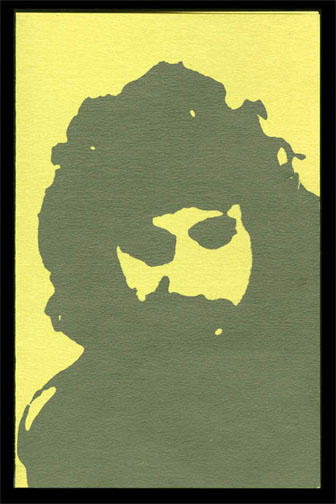
Program cover courtesy Walker Art Center
Cat Stevens
Michael Anthony of the Tribune noted that the audience for the first show begged for more until the room had to be cleared for the second show.
In performance Stevens sings with more abandon than on recordings. He sings and plays guitar with rapt concentration in near-perfect accord with his able sidemen: Alun Davies, guitar; Larry Steele, bass; and Gerald Conway, drums. Most of the material was taken from the last two albums: “Wild World, “Hard Headed Woman,” and the dialogue, “Father and Son,” among others. In the middle of the set he changed to piano accompaniment, playing simple but effective gospel style on “Miles From Nowhere” – perhaps his best vocal of the evening – and “Sad Lisa.”
Jim Crawford, reviewing for the Sun Newspapers, had one word for the concert: “Incredible.” Both reviewers wrote of Stevens’ struggle with tuberculosis after writing hits for others in the mid 1960s.
Marshall Fine, reviewing for the Star, hated to admit it, but he liked the concert as well. He was fed up with people liking anyone who came to town. But he found Stevens to be a passionate yet intense performer with a fascinating voice and an amazing range.
Judee Sill
Anthony:
Judee Sill played and sang the first set of the evening – primarily the same material she sang a month ago at the Tom Paxton concert. Her songs have a Western tone about them with a kind of loping-along rhythm. They seemed even better on a second hearing. They’re difficult songs with numerous large vocal jumps that give her a little trouble in the upper register.
SKOGIE & THE FLAMING PACHUCHOS
Skogie and the Flaming Pachucos, with Blue Freedom, performed on September 16, 1971. This performance was most likely in the Walker Art Center Auditorium. Both were local groups.
CROSBY & NASH
David Crosby and Graham Nash, with Judee Sill, performed on September 19, 1971, presented by the Walker. It was a capacity audience.
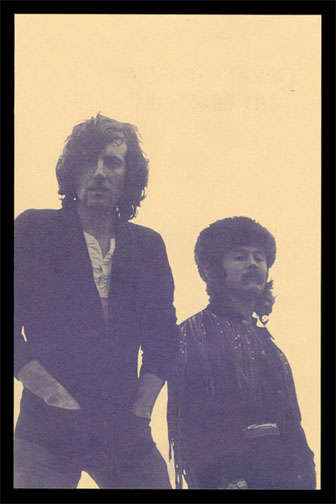
Program cover courtesy Walker Art Center
Crosby and Nash
Peter Altman of the Star complained that very little of the long time on stage was spent actually making music. “Dreary Persiflage” (light and slightly contemptuous mockery or banter) was tedious and was out of tune with the songs that were trying to be introspective, poetic, sincere, emotional, or some combination. They both had colds, which may or may not have accounted for their lack of communication and singing ability.
Michael Anthony of the Tribune put it more bluntly, calling the two performers “loose to the point of buffoonery. Crosby sang better but drowned out Nash. Anthony was annoyed at how the audience applauded at whatever they said, to the point of being ingratiating.
Judee Sill
This was the third time Judee Sill opened for a Guthrie act in three months. Altman found the same offbeat sense of humor, and streak of poetry and melodic originality she showed in June. He opined that she has the potential for stardom, but that she needed to learn more songs.
Anthony also noted that Sill included much of the same material from her two previous performances.
SHAWN PHILLIPS
Shawn Phillips appeared on September 26, 1971, presented by the Walker. He drew a capacity audience to his first local show.
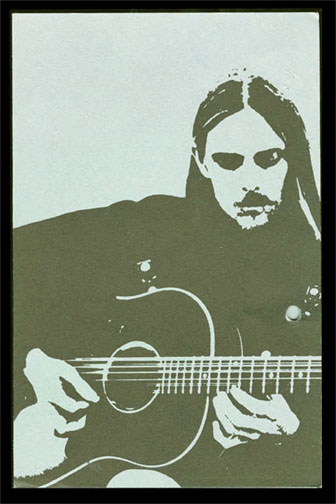
Program cover courtesy Walker Art Center
Peter Altman of the Star wrote that Phillips did not yet have a hit record, but apparently enjoyed an underground reputation and had the audience had confidence in Suzanne Weil’s instinct for spotting up and coming talent. His review uses the word powerful over and over again in different ways. Phillips plyed seven instruments: two electric guitars, three six-string acoustic guitars, a 12-string guitar, and a sitar. Sometimes he sang in his natural baritone, and sometimes in falsetto. Altman did not find that Phillips was consistently conveying much emotion, and despite his skill, “I was not truly affected.”
IT’S A BEAUTIFUL DAY – CANCELLED
It’s a Beautiful Day was scheduled to appear on October 3, 1971, at the Guthrie but the concert was cancelled due to a shakeup in the group that would necessitate hiring a new manager.
JOHNNY RIVERS
Johnny Rivers, with Fanny, appeared on October 10, 1971, presented by the Walker.
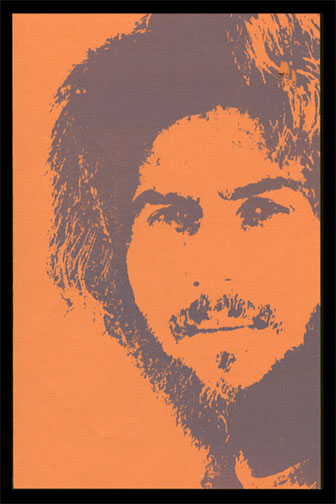
Program cover courtesy Walker Art Center
Johnny Rivers
Johnny Rivers came out with just an acoustic guitar and took it easy, reported Jim Gillespie of the Star. His set was a mixture of old and new tunes, met with loud cheers and applause from the audience. Gillespie wrote that his voice sounded better than ever.
Fanny
Fanny was an all-female group made up of Nicolee Barclay on Keyboards, June Millington on guitar, Jean Millington on bass, and Alice deBuhr on drums. They had one semi-hit, “Charity Ball.” Gillespie had a lot of good things to say about them, except that their mostly original material sounded too much the same and tended to get a bit monotonous. But he called it a cooking little band.
CARLY SIMON – CANCELLED
Carly Simon was scheduled to do two shows on November 14, 1971, but not enough tickets were sold. When the Walker contacted her management and asked them if she could do one show at a reduced fee, she declined, and the whole thing was cancelled. (Minneapolis Tribune, November 14, 1971)
BEACH BOYS
The Beach Boys gave two sellout shows on November 21, 1971, for their “Surf’s Up” tour, presented by the Walker.
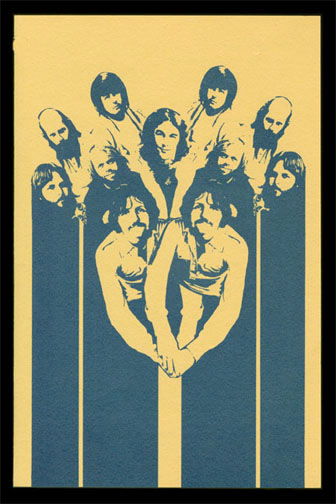
Program cover courtesy Walker Art Center
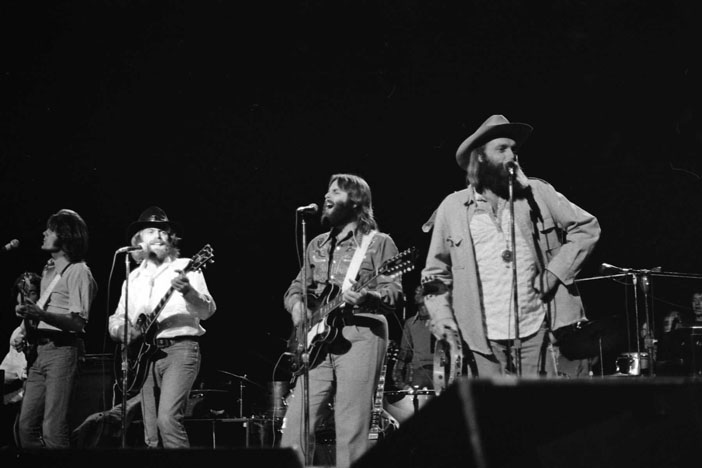
Photo copyright Mike Barich
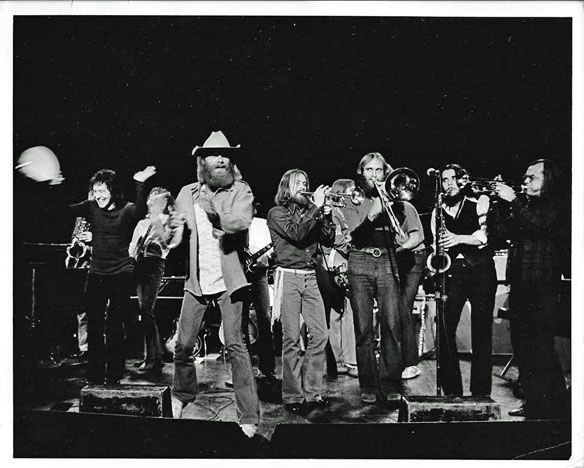
Photo courtesy Paul Berthiaume
The six official Beach Boys at this time were Carl and Dennis Wilson, Mike Love, Al Jardine, Bruce Johnston, and Daryl Dragon (later of Captain and Tenille). There were also seven supporting musicians and more instruments and speakers than had probably ever been set up on the Guthrie stage.
Peter Altman of the Star wrote:
Remarkable was the way sso much was blended. Melodies were counterpointed, rhythms alternated and opposed, harmonies fused and special effects integrated as one would have thought possible only by studio editing of separatly made tracks.
Michael Anthony of the Tribune tells us the band took requests at the end of the first show, and after a standing ovation did five encores before clearing the room for the second show. There were sound problems, with excessive feedback and too much bass making the lyrics hard to hear, but there were some lovely moments.
Ron Szybatka remembers:
I can honestly say I was at that one….and ( I know this will sound like BS, but it is true ) we sat front row just left of center. The band was phenomenal. Of course Brian was not there, and although Dennis was there they also had another drummer who could play well. There was quite a group of people on that stage, probably mostly session folks….as in….Daryl Dragon and Toni Tennille, who a couple years later became the Captain and Tennille. Both playing keyboards on either side of the stage and Toni contributing to the vocals. The vocals were beyond great, they were stellar and perfect. I would be remiss if I did not mention Carl Wilson’s superb vocals, especially on ” God Only Knows.” They did all the old kind of hokey stuff (but great) and did the stuff from “Pet Sounds,” which was amazing. We dumb lucked into those tickets because one of the guys in the band’s girlfriend worked at the ticket office. She called him and said that the tickets just came in and she could get five. The four guys in the band went, along with her. Of all the concerts I have seen in my life this one was one of the top for quality of performance, and I’ll say again, stellar vocals.
SEATRAIN
Seatrain, with Jonathan Edwards, appeared for two shows on November 28, 1971, presented by the Walker.
Jim Gillespie of the Star wrote that hardly anyone showed up for the first show, which was too bad, because the musicians were very good. They were Andy Kulberg on bass, amplified flute, and an echo-plex unit that enables a musician to play duets with himself with a tape delay. Lloyd Baskin was on keyboards and vocals, and Peter Rowan was on guitar and vocals. Rowal also yodeled. Richard Greene played electric violin and mandolin, and Larry Atamanuik was the drummer.
RANDY NEWMAN
Randy Newman, with Bonnie Raitt, appeared on December 5, 1971, presented by the Walker.
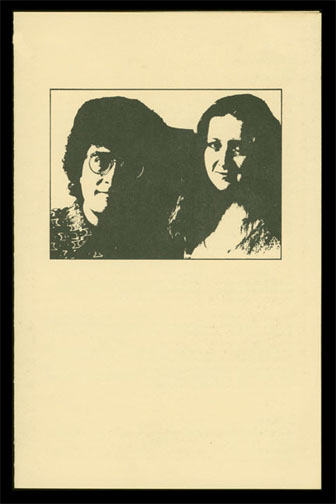
Program cover courtesy Walker Art Center
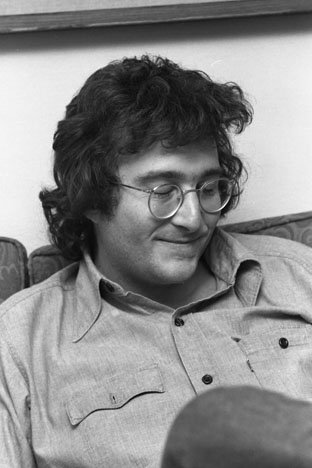
Randy Newman backstage – Photo copyright Mike Barich
Randy Newman
Peter Altman of the Star called this a relaxed and entertaining musical evening. Newman performed alone for an hour, singing and playing the piano with a combination of humor and sadness. Newman is best heard live, in order to get the essence of his humor. “He’s one of a kind.”
Bonnie Raitt
Bonnie Raitt, with eight accompanists, played blues for the first hour.
LEO KOTTKE
Leo Kottke performed on December 26, 1971, presented by the Walker. The concert was sold out.
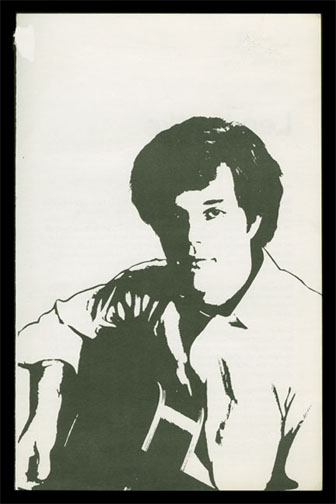
Program cover courtesy Walker Art Center
This was the second annual Leo Kottke Day After Christmas at the Guthrie Concert, but it was considerable hampered by sound problems and a sore throat, reported Jim Gillespie of the Star. He did some instrumentals, and sang a new number, but for the most part his voice was inaudible. He did tell some funny stories, though and established a warm rapport with the audience. During intermission there were some adjustments made to the sound system and there was a vast improvement.
1972
SEALS AND CROFTS – JACKSON BROWNE
Seals and Crofts, with Jackson Browne, performed on January 9, 1972, presented by the Walker.
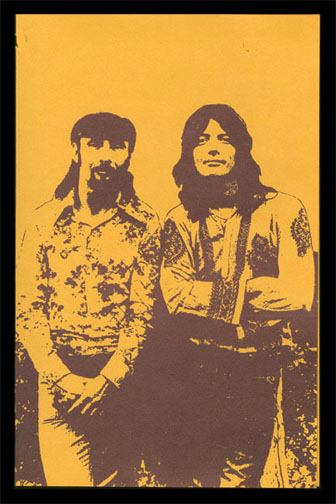
Program cover courtesy Walker Art Center
Seals and Crofts
Jim Gillespie of the Star reported that by the fourth encore, eight couples were dancing to the “frenzied fiddling and manic mandolin” of the duo. Jim Seals played guitar, fiddle and saxophone, and Dash Crofts played electric mandolin and electric piano. They were backed up by Bobby Lightig on electric bass.
Crofts was magnificent, whether picking out a delicate melodic passage or stomping on the fuzz-tone and using a wah-wah pedal. Seals complemented him perfectly with his light, jazzy guitar playing, and Lightig moved things along quite nicely with his subtle bass work. Both of the stars sing lead and they harmonize beautifully together.
At the end they invited the audience backstage to talk about the Baha’i faith.
Jackson Browne “was good too.”
William Clauson, a folksinger, performed on January 23, 1972, at 2:30 pm. His appearance was sponsored by the American Swedish Institute and the Institute’s male chorus, under the direction of Edgar Eklof, which was also on the program.
BILL WITHERS
Bill Withers performed on January 30, 1972, presented by the Walker.
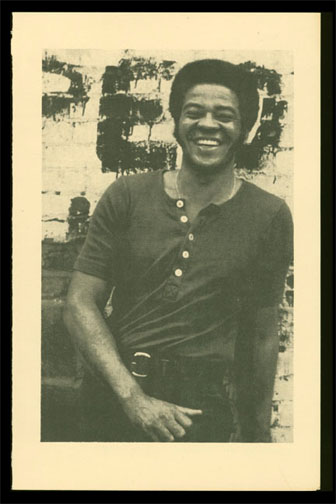
Program cover courtesy Walker Art Center
Charles Quimby, reviewing for the Star, wrote that his style was best suited to a night club rather than a concert hall, given his low-keyed manner and personal lyrics. Withers was backed by four graduates of the Watts 103rd Street Rhythm Band, led by guitarist Bernard Blackman.
M. Howard Gelfand of the Tribune came to the same conclusion, and also mirrored Quimby’s complaints about Withers’ bad jokes. Gelfand gave the last name of the band’s guitarist as Jackson. His name was actually Benorce Blackmon.
PRINE – GOODMAN – KOLOC
John Prine, Steve Goodman, and Bonnie Koloc performed on February 5, 1972, presented by the Walker. The crowd was estimated at 900.
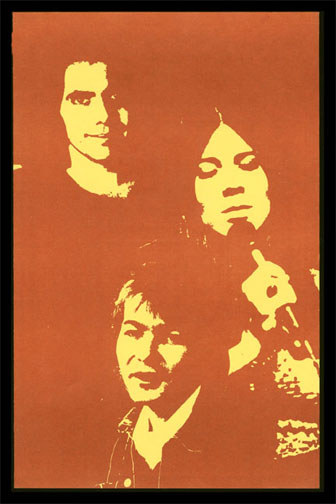
Program cover courtesy Walker Art Center
Steve Goodman started the show, described by the Star’s Peter Altman as engaging, lively, droll, bouy, likable, and entertaining.
John Prine’s solo set included just two songs not on his recently released debut album.
Bonnie Koloc sang with a four-piece band. Altman wrote that she had a clear soprano voice and was reliably on key, but her interpretations were unimaginative and unaffecting and she never gained any momentum.
After each performer had done their solo set, they teamed up for a short set featuring “Jamalaya.”
SKOGIE AND THE FLAMING PACHUCOS
Skogie and the Flaming Pachucos, with Blue Freedom and Michael Yonkers, performed at the Walker Art Center Auditorium on February 20, 1972, presented by the Walker.
Skogie and the Flaming Pachucos was made up of:
- Jim Greenberg : Woodwinds, Bass, Percussion, vocal.
- Mark ‘Bugs’ Goldstein : Keyboards, Guitar.
- Al Galles : Drums, Piano, Vocals.
- Dennis Peterson : Bass, Vocals, Guitar.
- Rick ‘Skogie’ Moore : Vocals, Guitar, Keyboards, Drums
In the photo below, Denny, who usually played bass, was playing keyboard. Mark, who usually played keyboards, was playing guitar. Jim, who most often played woodwinds, was playing bass. Rick was on guitar and Al was on drums.
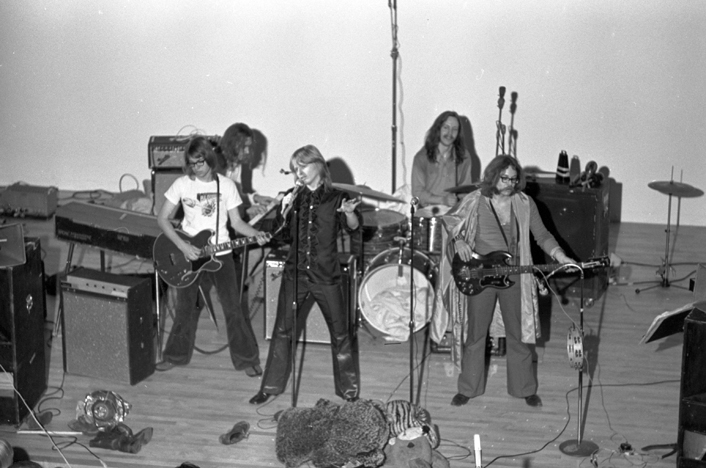
Skogie photo copyright Mike Barich
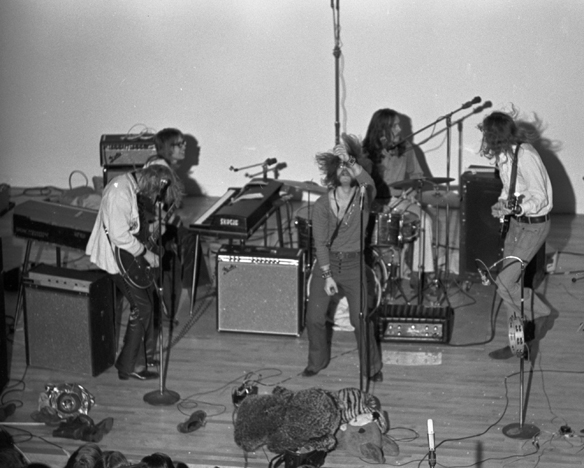
Skogie photo copyright Mike Barich. Jim was in action in the middle.
Blue Freedom was organized by Milo Fine.
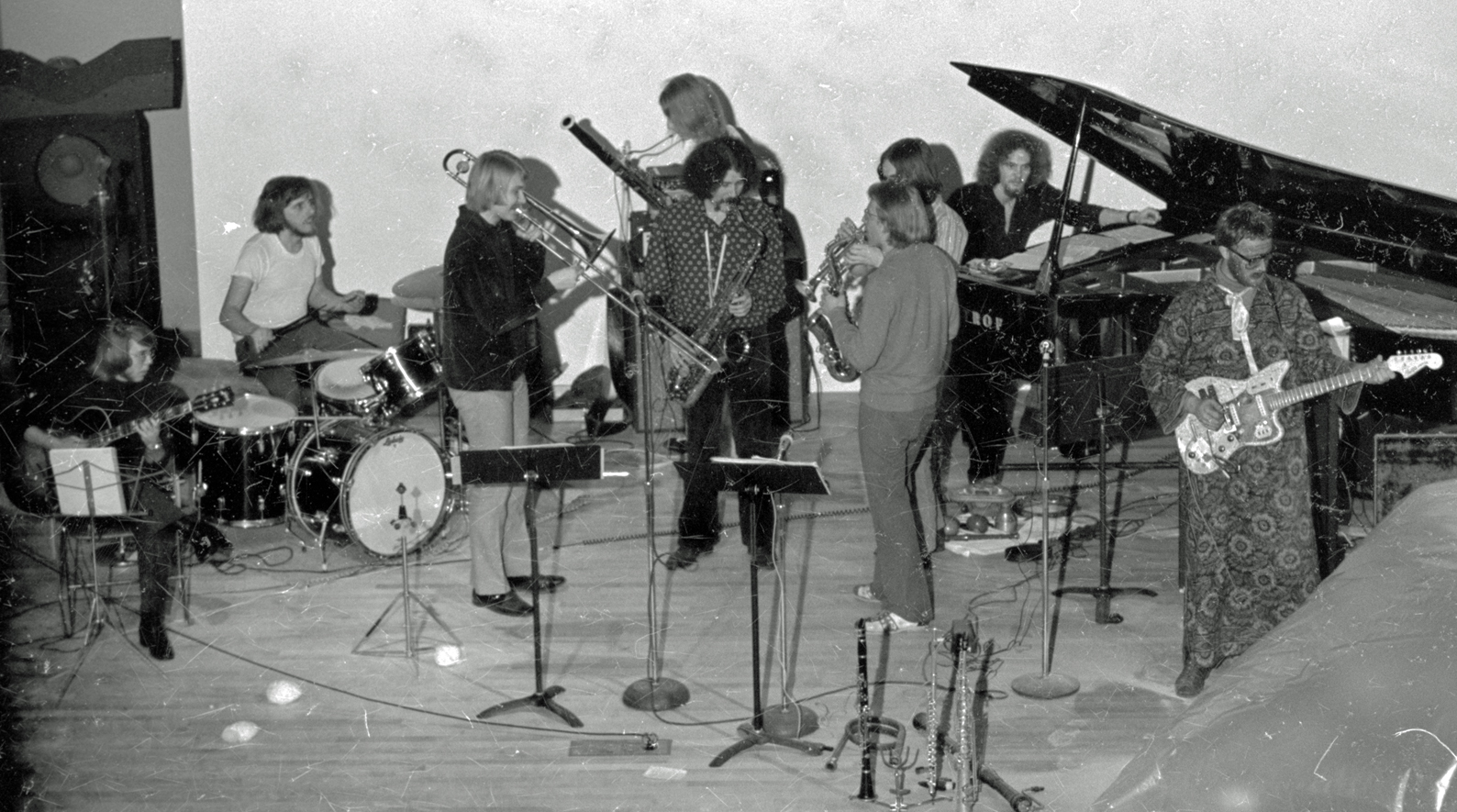
Blue Freedom, with Michael Yonkers on the right – Photo copyright Mike Barich
MAHAVISHNU ORCHESTRA
The Mahavishnu Orchestra, with Michael Johnson, performed on February 27, 1972, presented by the Walker. There was an almost capacity crowd of 1,200.
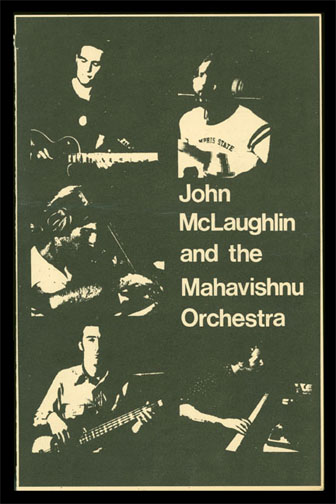
Program cover courtesy Walker Art Center
John McLaughlin
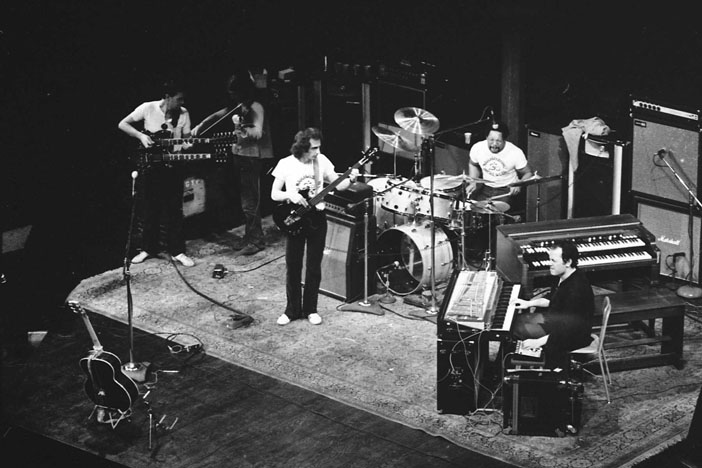
Photo of John McLaughlin copyright Mike Barich
John McLaughlin was a British guitarist with a background in classical music, blues, and jazz. The music of the Orchestra reflected his interest in Indian philosophy. Members were William Cobham on drums, Rick Laird on bass, Jerry Goodman on violin, and Jan Hammer on piano.
Roy M. Close, reviewing for the Star, called this one of the most exciting and exhilarating concerts he had heard in a long time. The opening number was “The Inner Mounting Flame,” which lasted 20 minutes. After a pause that lasted just long enough for McLaughlin to announce the next number, the orchestra launched into “Dawn,” which featured an intricate and demanding solo by McLaughlin. Close deemed the performance “vibrant, musically interesting and artistically proficient.” The audience gave the orchestra a rousing – and well deserved – standing ovation after close to two hours of virtually non-stop performing.
Michael Johnson’s set was deemed articulate.
SHAWN PHILLIPS
Shawn Phillips returned to the Guthrie for four concerts on April 23 and 24, 1972 (2 sellout shows each night), presented by the Walker. He played the guitar and sitar.
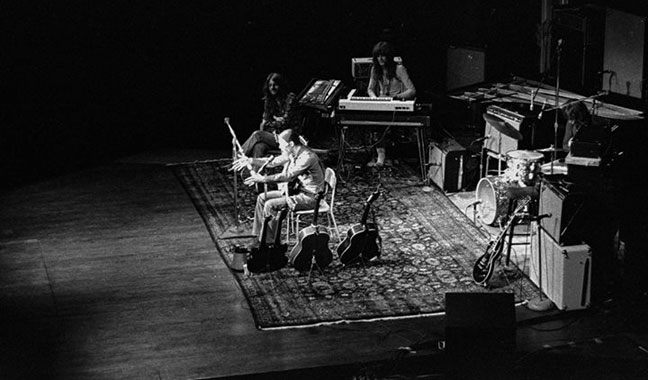
Photo courtesy Mike Evangelist
Roy M. Close of the Star reported that Phillips started with several solo numbers, then brought on his sidemen for the final 45 minutes.
Throughout the concert, he deonstrated vocal versatility and power, solid if unspectacular musicianship and infectious stage manner. He played several new songs that tend to make more frequent use of dissonant chords and unpredictable melodic skips than his earlier numbers.
Close rightly predicted: “I think his popularity will not fade quickly.” An indication was that most of the people who had bought tickets for the first show had also purchased tickets for the second show.
PHILLIP GLASS
Philip Glass performed on April 29, 1972, at the Walker Art Center Auditorium, presented by the Walker.
TOM RUSH
Tom Rush performed on April 30, 1972, presented by the Walker. He was backed by three sidemen.
Peter Altman of the Star expressed disappointment in Rush’s movement away from his initial traditional blues and folk music of the ’60s, writing that his recent records had been increasingly overproduced and gimmick-riddled. The Guthrie concert confirmed that he had “lost musical determination and self-awareness.” Even his songs from the past were performed in an “offhand, almost ramshackle” manner. The new material was almost consistently uninteresting. His singing and stage style was mannered, with a phony hillbilly facetiousness.
IT’S A BEAUTIFUL DAY
It’s a Beautiful Day, with Jim Croce, performed two sold-out shows on May 7, 1972. This was no doubt the rescheduled concert that was cancelled in October 1971.
It’s a Beautiful Day
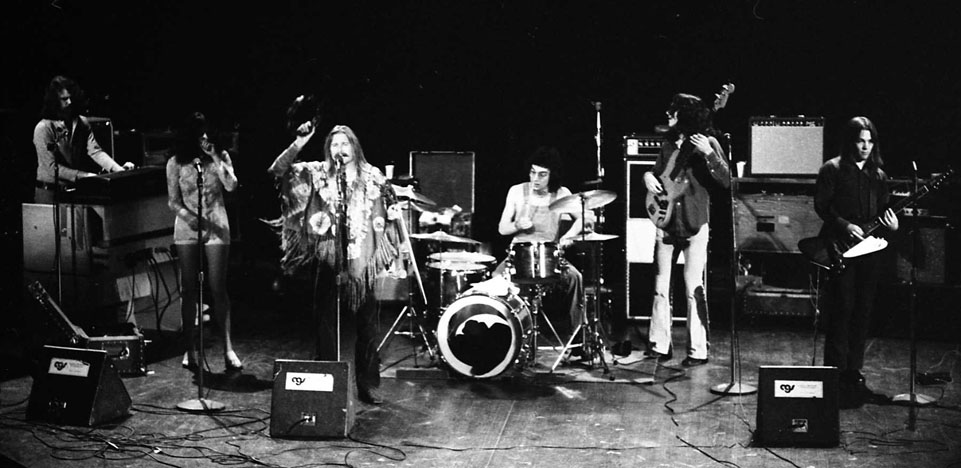
It’s a Beautiful Day – Photo copyright Mike Barich
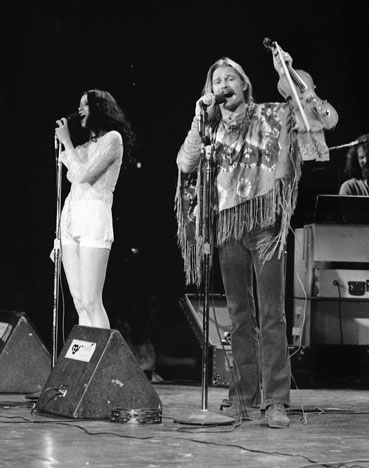
Photo copyright Mike Barich
The six-member group formed in 1967 by Pattie Santos. Other members were David LaFlamme (vocals, violin), Bill Gregory (lead guitar), and Val Fuentes (drums). Star reviewer Roy M. Close was not impressed with the group during the first half, but the second half was when they performed their signature songs “Hot Summer Day” and “White Bird.”
Jim Croce
Many thought that opener Croce blew the main act away. Croce may have been a replacement for Billy Joel, whose name is on one Walker list. Close wrote that Croce sang and played acoustic guitar with spirt and an entertaining style that he found appealing.
TODD RUNDGREN
Todd Rundgren made his Twin Cities debut at the Guthrie on June 4, 1972, with the Hello People opening. The show was presented by the Walker.
Marshall Fine’s review in the Minneapolis Star the next day describes a strange show – but maybe not so strange for 1972. About 350 people were “congregated in the center of the main floor” – sitting on the floor? Okay, even Fine calls the opening strange. His review is so lovely that I will quote most of it.
Four guys in red leotard tops can be seen milling around on the dim stage. Over the sound system, crowd noises, symphony warmups, then a gruff voice, saying, “And now, the Todd Rundgren Show, with the Hello People.”
And the lights come on and those four guys in red leotard tops are all wearing makeup, yes, makeup – white-face and eye highlights. They do a perfunctory little warmup tune. Then there there’s no sound – they’re doing a mime about eating apples.
In extreme slow motion, they glide back to their instruments and play a song that slows to a steady “chukk-chukka-chukk” as one of them marches forward and describes, in words and motions, the hacking open of a person’s chest with an ax by “the mad red ant lady,” who then puts ants all over the wound. The crowd is in stitches.
Then on marches an additional trio, more conventionally dressed. The one at the organ looks like some insane buccaneer, with a scarf on his head and what looks like a Chiquita Banana sticker on his forehead. The guitarist, whose name is Tom Cosgrove, sings a short blueser, ending in a sweeping five-part a cappella chorus. The crowd cheers. A voice on the mike says, “And now Todd Rundgren,” and this wraith slides onto the stage, two-tone blue blazer glimmering. Into his guitar and whammo – this gigantic St. Bernard growling voice is blowing the guts out of everyone.
Which wouldn’t be so odd, except Todd Rundgren is noted for his high school love songs. He’s skinny enough to hide behind a microphone stand and he’s got a sort of demented high school dopey smile on his face.
Rundgren was right in there, though, yesterday, sailing through his hit, “I See the Light” (not a religious song: the light is “in your eyes”), plus tunes from his album, “Something-Anything?” and a golden oldie from his days with Nazz, “Hello It’s Me.”
MAHAVISHNU ORCHESTRA
The Mahavishnu Orchestra with John McLaughlin returned to the Guthrie on August 13, 1972. The sold-out show was presented by the Walker.
Michael Anthony’s review in the Tribune reported that the audience cheered and applauded as soon as the orchestra walked out on the stage. Anthony called them “perhaps the most contemporary group around.” He described their music as “Loud, restless, generally atonal improvisations, usually opening and closing with a somewhat ethereal ensemble melody.” McLaughlin played a double necked guitar, one neck with twelve strings, one with six. Much of the program came from the group’s album, “Inner Mounting Flame.”
The rest of the orchestra was Jan Hammer, a Czechoslovakian pianist and synthesizer player; Rick Laird, an Irish bassist; Billy Cobham, drummer; Jerry Goodman, violin.
Roy M. Close, writing for the Star, noted that, compared to the show at the Guthrie the previous February, there were some technical difficulties, including a persisten buzz in the loudspeaker system and sloppy handling of spotlights. The show was not as precise as it was six months previous either, Close said.
PURE FOOD AND DRUG ACT – [ARGENT]
Pure Food and Drug Act took the stage on August 20, 1972. The group was hired to be the opening act for Argent, but the English group missed a plane connection in Seattle due to a sky-jacking incident on the West Coast.
Some chose to get a refund for their tickets, but most of the audience stayed to hear the Americans, and the theater was three-quarters full to see the PF&DA. The group had some veteran musicians, said reviewer Marshall Fine:
- Don (Sugarcane) Harris on violin – Frank Zappa and John Mayall
- Harvey Mandel on guitar – Canned Heat and John Mayall
- Paul Logos, Percussion – Mayall and a longtime studio musician
ARGENT
Argent made up the date on September 3, 1972, presented by the Walker. Rod Argent was the former head of the Zombies and the group had a small but ardent (!) audience at the Guthrie. The theater was only one-third full and the show was an hour and five minutes late, but Star reviewer Marshall Fine called it one of the most exciting sets seen here in months.
It contained elements of heavy blues, pretty harmonies, well-coordinated and numerous time changes, odd syncopation and even boogie woogie. Rod Argent showed himself to be a diverse and skillful keyboard artist, fervently unleashing solo after well-wrought solo, both on organ and electric piano.
Other members of the band included Russ Ballard, lead guitar and vocals; and Jim Rodford, bass.
(Marshall Fine review, Minneapolis Tribune, September 4, 1972)
NEWMAN AND CROCE
Randy Newman, with Jim Croce, performed on October 8, 1972, presented by the Walker. A near-capacity crowd turned out.
Randy Newman
Croce and Newman often played double bills, according to Michael Anthony’s review in the Tribune. Newman was Newman, and Anthony called him “one of the most competent and interesting songwriters today.” He was called back after his set for several encores.
Peter Altman, reviewing the concert for the Star, wrote that Newman was consummately artistic. He played mostly familiar works with few surprises, but his songs are acute and well-crafted.
Jim Croce
Anthony wrote that Croce’s opening set consisted of about half from his album “You Don’t Mess Around With Jim.” His back-up guitarist was Maury Muehlheisen, who also added occasional vocals. Altman detected a disconnect between Croce’s melodies and lyrics, and his rather unclear enunciation made it difficult to understand.
Altman wrote that Croce’s set was unremarkable if pleasant enough. Croce told amusing anecdotes and his songs evidenced some sophisticated musicianship, but were considerable less distincitive.
COMMANDER CODY
Commander Cody and His Lost Planet Airmen, with Merry Clayton, performed on October 29, 1972, presented by the Walker. The crowd was about 90 percent capacity.
Commander Cody
In his review for the Star, Peter Altman reported that Commander Cody gave not the customary one, but two shows, lasting from 8 to 11: 15 pm. It was advertised as one concert, so they must have just kept going.
The group’s members included Andy Stein on fiddle and saxophone, Bobby Black on pedal steel guitar, John Tichy on lead guitar and vocals, and Commander Cody on stride piano. On most songs there were three singing guitarists.
Merry Clayton
Altman characterized Merry Clayton as singing “funky but not particularly distinctiv or affecting blues accompanied by five instrumentalists.”
PAUL WINTER CONSORT
Paul Winter Consort – a six man jazz group – performed on November 5, 1972, presented by the Walker.
CURTIS MAYFIELD
Curtis Mayfield, with Danny Holien, performed two shows on November 12, 1972, presented by the Walker. Mayfield sold out both shows, but the first was only 45 minutes long because he got lost in the Lyndale Ave. bottleneck and eventually had to call for an escort to find his way to the theater.
Curtis Mayfield
Tom Murtha, reviewer for the Star, reported that Mayfield received a warm welcome, and performed material from “Superfly” in his trademark falsetto. He made note of his young age (around 30) and his 12 years’ experience in the Impressions; his band members were from the Impressions:
- Craig McMullen: guitar
- Tyrone McCullen: drums
- Lucky Scott: bass
Also in the group was Henry Gibson on bongos, congas, and tumbas, reflecting Mayfield’s growing interest in Afro-Cuban rhythms, influenced by Santana.
Murtha analyzed Mayfield’s deepening maturity as a songwriter:
His view is that of a humanist, seen through black eyes. His songs take a slice of life. A musical journalist, he can talk of blacks and whites sitting on the same big city bus, all working the same job for the same pay and all staring at each other with the same mistrust.
His rhythm and blues is soul with a vision.
Danny Holien
The show opener, Danny Holien, was a native of Cannon Falls, Minnesota, who had a folk record called “Colorado” on the local charts. His band Eat featured Minneapolis bassist John Sutphen. Murtha deemed the music “tight, punchy, energetic,” but smacked of country rock and “was about as welcome to the crowd as a polka band would have been at the closing concert of the Fillmore East.” In fact his opening headline was “Pre-Show Not Welcome.” Ouch. To make matters worse, the sound system got unplugged five bars into his first song.
TAJ MAHAL
Taj Mahal, with Steely Dan, gave two sold out shows on November 19, 1972, presented by the Walker.
Taj Mahal
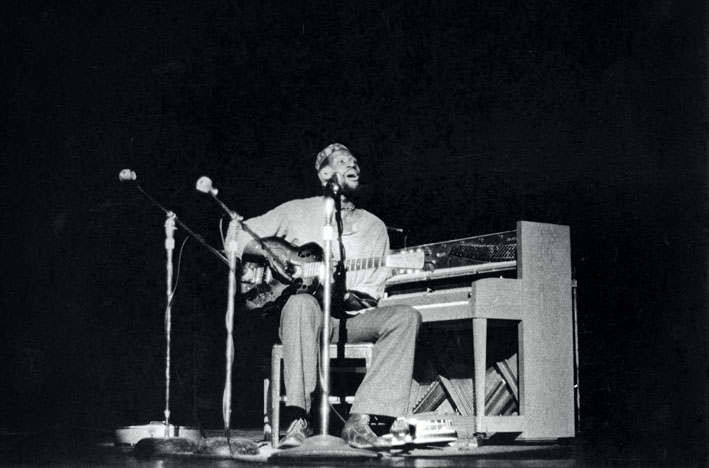
Photo of Taj Mahal copyright TomBerthiaume
While Mahal appeared in 1971 with an eight-piece band, for this show he performed solo. He accompanied himself on piano, guitar, steel-bodied guitar, banjo, and an African thumb-piano called the kalimba. Minneapolis Star reviewer Roy M. Close described his music as traditional Southern black blues, inspired jazz renditions of songs like “Jelly Roll,” and his own blues-oriented tunes. They were humorous, whimsical, and always captivating, said Close.
Michael Anthony’s review in the Tribune reported that Taj came out alone and dedicated the proceedings to chasing “the devil out of the room.” His material was “old plantation work songs,” although he was born in New York City. Anthony found it tedious.
Steely Dan
This was apparently the local debut of Steely Dan, who opened with a half hour set of what Close deemed to be “solid but utterly ordinary.” “The group played cohesively and at times well – but its music was predictable and uninteresting, and its lead singer resembled Mick Jagger much less than he thought he did.”
Anthony found some of Steely Dan’s set undistinguished, but with a couple of good, old-fashioned rock and roll numbers.
DRAFT BENEFIT
On November 26, 1972, Willie and the Bumblebees, Dave Ray, Mark Naftalin, and Tony Glover performed a benefit for Minnesota Draft and Military Help, a draft counseling program. The show was sponsored by the Newman Center and held at the Guthrie.
PATTI SMITH
Patti Smith, with Susan Martin and Tony Glover, read some of her poetry in the Walker Art Center Auditorium on December 3, 1972, presented by the Walker.
There was no review in the Star or Tribune; I’ll bet there was in the Minnesota Daily, but the Daily went offline. The articles in the Star and Tribune on the day of the event said that Patti described herself as a “New Jersey swamp child/New York street poet.” Turns out that it was Tony Glover who was trying to promote his favorite poet, according to the Tribune. Glover and Martin would accompany her on guitars and harmonicas. Glover described her poetry:
It’s real good, man, she’s the best poet I know. It’s not just intellectual and academic, it’s more natural, like street rhythms, rock rhythms. It’s kind of horny. I’d call it horny; she’d call it dirty, dealing with sex and sensuality. Not like those other cats, you know, who write, “I was walking by the sea and saw a sand crab,” and then write 45 pages on the sand crab.
She’s hip to Lorca and Rimbaud, and she has style and class and she performs when she reads; she doesn’t just stand there and get the audience up tight. She’s a good performer.
She’s acted off-Broadway and she used to be an assistant to a fire eater on the Paris streets. She co-authored a play that ran one performance and she warms up the audience before rock shows at the Mercer Arts Center in New York for two shots of Wild Turkey and four bucks a night.
She’s a combination of tough, hillbilly chick – she was mistaken for Keith Richard once in the Paris airport and chased by four chicks who caused her to miss her plane – but she can be a little girl, too. That’s enough. For the rest, you gotta see her.
Patti Smith would return to the main stage on March 7, 1976.
BOZ SCAGGS, DR. JOHN
Boz Scaggs, with Dr. John the Night Tripper, performed two shows on December 10, 1972, presented by the Walker.
Boz Scaggs
Marshall Fine, reviewing for the Star, found Boz Scaggs’ music to be crisp, clean, and extremely likeable. He touched all bases: rock, blues, rhythm and blues, samba, even classical. Many comparisons were made to Van Morrison, and indeed one of his sidemen, Jack Schroer, on tenor and soprano saxophones, appeared on Morrison’s “Too Late to Stop Now” seminal live album. Scaggs was also backed by Joachim Young on four keyboard instruments.
Dr. John
Dr. John rated a complete description in Fine’s review:
Dr. John, whose real name is Mack Rebennack, played the whole show in one of the most flamboyant get-ups evr displayed on the Guthrie stage. Leathers, furs, talismen and puches hung from his chest. His face and beard were spangled with purple glitter and his head adorned with a headdress topped by multi-colored feathers.
Dr. John sang growly, bouncy blues in a voice that sounded like metal dragging on asphalt. He had a rolling, barrelhouse piano style, which was obscured by a bad sound system. While his music began to drag after a bit, his showmanship obscured the fact for most of the performance.
LEO KOTTKE
The Leo Kottke Christmas Show, performed two shows over December 19-20, 1972, was taped for a live album. The show was presented by the Walker. Also referred to as the Leo Kottke Revue, or the Third Annual Walker Art Center Presentation of Leo Kottke at the Guthrie.
Billy Peterson and Bill Berg, who performed on Dylan’s “Blood on the Tracks” album in 1974, participated in this performance.
In his review for the Star, Tom Murtha described the show as “Felliniesque.” First up was magician Bruce Russel, who chain smoked an entire pack of cigarettes which he drew burning, one by one, from his sleeve.
Next came Jose Cole, who balanced on a pedestal upon his index finger.
Finally there was Wally Pikal, who ordinarily led and old-time band. Here he played “Stars and Stripes Forever” on three trumpets while jumping about the Guthrie stage on a pogo stick, which he brought in a guitar case.
Then it was time for Kottke, who was a hugely popular and talented guitar player.
1973
BACK TO BLACK
Back to Black was a benefit show put on by and for 13-17 year old musicians from the New Way Community Center on January 2, 1973. Presented by the Walker in the Auditorium.
MILES DAVIS
Miles Davis performed two shows on January 28, 1973, presented by the Walker.
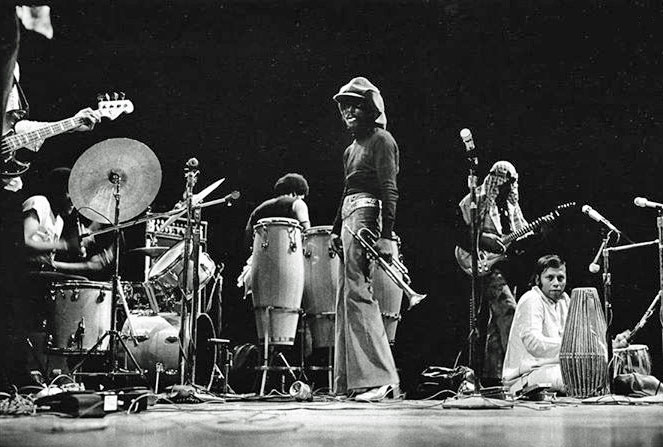
Miles Davis – Photo copyright Mike Barich
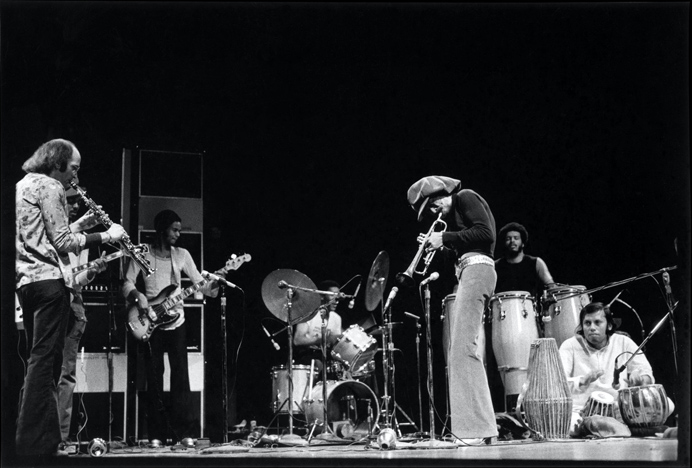
Photo courtesy Walker Art Center Archives
Tom Murtha reviewed the show for the Star, and called Davis “god-like and transcendant.”
Each of his concerts is committed to legend thirty seconds after it ends. People remember where, and with whom, they heard it – but most of all, they remember the music, because it is never the same. The first set lasted an uninterrupted hour and a half, and bore scant resemblance to anything Davis had recorded.
Davis had assembled a new group, except for bass player Mike Henderson – young players with vitality and openmindedness, wrote Murtha. The music was much more than rock and roll, but it was also much more than jazz. Davis kept his “distainful” back to the audience as always. He fumbled with his electrodes for awhile, and finally gave up and played his horn open and unelectrified. He left the stage for 20 minutes for a keyboard solo, and when he returned he played the blues – and nobody plays a blues the way Miles Davis does.
DAN HICKS
Dan Hicks and His Hot Licks performed on February 4, 1973, presented by the Walker. More than 1,400 were in attendance.
In his review for the Tribune, Michael Anthony explained that the six-member band played swing and pre-swing from the late 1920s to the early ’40s, with an occasional nod at the ’50s.
As front man, Hicks (who looks like a young mustached Lee Marvin) gives the group a deceptively casuall, flakey ambience via his rambling and often introductions. But the fact of the matter is that Hicks and company are a shrewdly organized buncch of very talented musicians. And it’s a shame more oldsters, who have more memories of this kind of music, couldn’t tear themselves away from the TV set on a Sunday night to see Hicks perform.
Hicks and two girls, Maryann Price and Naomi Ruth Eisenberg (known as the Lickettes) handled the vocals, with Eisenberg doubling on violin. Sid Page played violin and mandolin; John Tichy was on guitar, and Jaime Leopold on bass. With the exception of “I’m an Old Cowhand,” the tunes were original, although reminiscent of artists such as the Boswell Sisters; Lambert, Hendricks, and Ross; Connie Francis; and Django Reinhardt.
Marshall Fine, reviewing for the Star, wrote an unusually (for him) glowing piece, calling it
one of the most strikingly original concerts I’ve seen in a long time, combing showmanship, humor and tight musicianship. He turns each song into a small, many-faceted jewel that can sparkle or shine as his mood dictates. The music is captivating and refreshing.
Fine began his review with “Why Dan Hicks and the Hot Licks isn’t a super-group is beyond me.”
WEATHER REPORT
Weather Report performed two near sellout shows on February 11, 1973, presented by the Walker.
Tom Murtha, reviewing for the Star, described Weather Report as a five man esoteric, jazz-oriented group with international roots.
Members consisted of:
- Josef Zawinul: Keyboards (Vienna)
- Wayne Shorter: Saxes (U.S.)
- Miroslav Vitous: Bass (Czechoslovakia)
- Eric Gravatt: Drums (U.S.)
- Dom Um Romao: Percussion (Brazil)
Murtha was disappointed in the audience’s unresponsiveness, and would have preferred dancing in the aisles to the closing standing ovation.
DAVID BROMBERG
David Bromberg performed to a capacity crowd on February 24, 1973, presented by the Walker.
Marshall Fine’s review for the Star reveals that Bromberg had been primarily a session guitar player, and had played back-up on more than 50 albums, including work for Bob Dylan. His favorite kind of music was urban blues of the 1920s. Fine wrote that he was not a good singer, but that he “conveyed the despair and pain of the blues he played with a sensitivity [he] had seldom heard.”
Bromberg’s band, The Unnatural Act, included Neal Rossi on mandolin and fiddle, and John Paine on saxohones, clarinet and flute. The group got three standing ovations.
PRINE – RAITT
John Prine with Bonnie Raitt performed two sold-out concerts on March 10, 1973, presented by the Walker.
John Prine
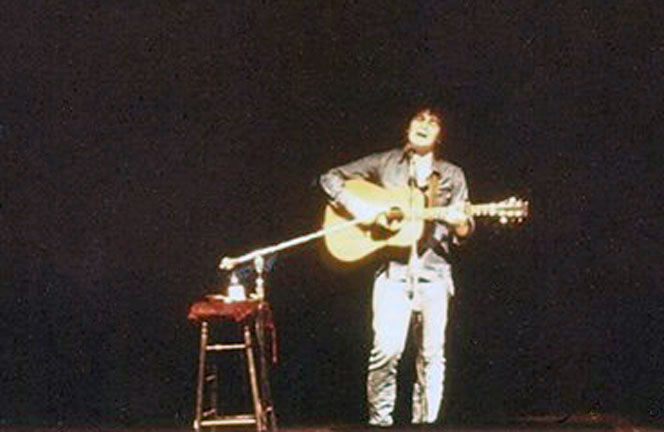
Photo of John Prine posted on Facebook by Steve Klemz
Michael Anthony, reviewing for the Tribune, called Prine “the best lyricist in the country today.” His concert was “rich with humor and originality.”
Judging from the response from the young audience, Prine’s tune “Illegal Smile” had become a drug culture anthem. The subject of his songs is often lonliness.
Anthony found Prine as a performer to be “a bit shy, to say the least. With his guitar at his chest he looks like the proverbial youngster forced out into the living room to perform for the neighbors. But his delivery, with a voice so reminiscent of the early Bob Dylan, is immensely effective, nonetheless.” The material performed was made up largely from Prine’s two albums.
Roy M. Close of the Star was effusive, calling Prices show one of the finest Walker-sponsored concerts of this or any other season at the Guthrie. “This tunes, mostlyy about the personal relationships of ‘ordinary’ people, are simply the best pop songs being written today. They are witty, poignant and unfailingly fresh in their use of detail.”
Prine sang 17 songs, from his two albums plus three others. “All considered,” Close wrote, “Prine’s hour-long set was distinctive, first-rate entertainment.”
Bonnie Raitt
Anthony found Bonnie Raitt to be anything but shy, however. He found her music to be “a delightful blend of country blues tunes plus material by Joni Mitchell, Jackson Browne and Fred McDowell. She sings well, in a rich flexible, bluesy voice and her guitar work (nicely backed by her bass player Freebo) is more than competent.”
Close wrote that Raitt was neither an outstanding vocalist nor an unusually remarkable interpreter, but she coste interesting material, used her range effectively, and handled her songs well. He thought she sounded tired, but found her set pleasant and enjoyable. Her material included songs by Christ Smither, Joel Zoss, Eric Kaz, and “Spider” John Koerner.
BETTE MIDLER – CANCELLED
The Divine Miss M was originally scheduled to appear at the Guthrie on March 13, 1973, but for some reason that fell through. The file at the Walker has notes that she was negotiating to appear that fall at Northrop Auditorium, perhaps co-sponsored by the Walker and the MSA Bookstore of the University of Minnesota, but that didn’t happen either. According to a website listing her concerts, she didn’t make it to Minnesota until 1983.
MAHAVISHNU ORCHESTRA
John McLaughlin and the Mahavishnu Orchestra performed two sold-out shows on March 18, 1973, presented by the Walker. This was its third appearance at the Guthrie in 13 months.
Roy M. Close of the Star opined that the group coninued to be one of the most imaginative and interesting jazz ensembles that enjoys a popular following. The first set showed nothing especially new in terms of its harmonics and rhythms, but most of the music was comparatively new.
Distractions haunted the performance: humming speakers, sticky keys on Jan Hammer’s piano, and a spotlight that was meant to turn the performers different colors, handled badly.
The opening act was the Capital Quartet of the St. Paul Chamber Orchestra, which performed George Crum’s “Black Angels.”
Close:
The 1970 work, scored for electric string quartet, is so stuff with dar, abstruse symbolism that one literally needs a chart – supplied, somewhat surprisingly, with the program – to begin to comprehend it.
STEVE GOODMAN
Steve Goodman played two shows on May 6, 1973. Jim Croce was scheduled to headline, but cancelled at the last minute due to illness. Minneapolis Star reviewer Roy M. Close said that many people chose refunds, but 700 stayed for two sets by singer-composer Goodman. Close called the sets appealing and well-played, especially when singing his own compositions.
DAVID BROMBERG
David Bromberg performed to a full house on June 3, 1973. He and his group had just been at the Guthrie in February, 1973.
Marshall Fine’s review reminded us that at the February show, the group had only been together less than a week, and that there had been some rough edges. This June performance, lasting almost three hours, was deemed “an act to be reckoned with.
The band, whose name kept changing, included: John Paine (saxophones, clarinet, and flute); Peter Ecklund (French horn and cornet); Neal Rossi (violin, guitar, mandolin, and piano).
The group’s repertoire included a number of styles and eras of music, including reels, blues, cha-chas, and country. The show included a guitar rendition of an old Scottish fiddle tune, and an a cappella version of a Mormon travel song of the 1800s.
As before, Bromberg, mentioned how much he appreciated the reception he got from Minneapolis audiences and how much he enjoyed playing at the Guthrie.
I have a note here that the show featured a jam with Bill Quaiteman. That was not in Marshall Fine’s review. There was only one show. I Googled Bill Quaiteman and came up with a Bill Quateman, who had a song at the bottom of the charts in 1973. That Bill Quateman? Please contact me if you know!
BOBBY LYLE
Bobby Lyle performed to a near-capacity crowd on August 26, 1973, presented by the Walker.
Michael Anthony of the Tribune reviewed the nearly three-hour concert by local keyboard player Lyle, who had spent two years recording and touring with Young-Holt Unlimited. Lyle was about to represent the U.S. in October 1973 in the Yamaha International Keyboard competition in Japan.
Lyle opened both halves of the concert with a 12-minute piano solo, “a kaleidoscope of various rhythms and styles, from stride to walking bass to quasi-fugal effects.”
Performing with Lyle were Eric Gravatt, percussion (recently from Weather Report); Bob Rockwell, winds; and Billy Peterson, bass.
At the end, Myron Johnson of the Children’s Theater lead a group of seven dancers in an “exuberent, though not totally precise” choreographed treatment to one of Lyle’s compositions.
Roy M. Close reviewed Lyle’s concert for the Star, and referred to it as the first of the Walker’s resurrected “Jazz at the Guthrie” concerts. Close wrote that Lyle alternated between piano, electric piano, and organ, sliding from one bench to another, or simply reach across to play two instruments at the same time.
When he finally settled at the organ for his longest solo of the evening, Lyle swiftly demonstrated the potential of thaat instrument, using stops to create whistles, shrieks, eerie sighs, tremulous bleeps and percussive pops. There was a bit of almost everything, including a snatch of a blues melody and a passage in which the soloist held an octave’s worth of keys down with his right hand while he played the stops with his left.
MINGUS
Charles Mingus performed two shows on September 23, 1973, presented by the Walker. Reviewer Michael Anthony of the Tribune reported that the second show started at 10:37 and lasted for 70 minutes.
Roy M. Close of the Star reported that the audience was less than half-filled for the first show; he was told the second show drew slightly more.
His sidemen were Ron Hampton on trumpet; George Adams on saxophone; Doug Hammond on drums; and Don Pullen on piano. Close wrote that the group gave a remarkablely unaffected performance.
HICKS AND MULL
Dan Hicks, with Martin Mull, performed on September 30, 1973, presented by the Walker. The crowd was about two-thirds capacity.
Marshall Fine of the Star, who had given Hicks an exemplary review for his February 4, 1973, performance, noted that the Hot Licks had broken up and Hicks was in a personal and professional decline.
Backed by bassist Jaime Leopold and guitarist John Girton, holdover Hot Licks, Hicks slouched and drank throughout an uninspired 75-minute set, during which a number of people walked out. His voice wandered endlessly, he had a difficult time staying on key and his approach to the show bordered upon – and sometimes crossed into – outright contempt for the audience.
Fine had lots of good things to say about opening act Martin Mull and his absurd sense of humor
Billed as “Lonesome Dan Hicks,” one concert goer said he was “fall-over drunk and embarrassing… Mull was very funny and Hicks kept saying stuff between songs like ‘I hate that %#} Martin Mull.'”
Musician Jerome Lawrence Beckley was at the show and remembers:
Mr. Hicks did not have the women singers that night and that displeased the audience. Hicks proceeded to get very intoxicated onstage in front of us. After the show I went to the Home Bar and sat in with friends who were playing there that night. Hicks came into the bar with a long legged blonde and disappeared into the bathroom. When he burst into the front door of the bar I announced his presence and he shouted back, “Don’t blow my cover!” My Dan Hicks story.
Dan Hicks died on February 6, 2016, at the age of 74 of throat cancer.
JIM CROCE/TONY JOE WHITE – CANCELLED
Jim Croce was scheduled to perform at the Guthrie on October 7, 1973, opened by Tony Joe White. This was probably a re-schedule of the concert Croce missed the previous May. Unfortunately, the show was cancelled as Croce died on September 20, 1973.
POINTER SISTERS – MULL
The Pointer Sisters, with Martin Mull, did two sold-out shows on November 11, 1973, presented by the Walker.
Pointer Sisters
Star Reviewer Roy M. Close called the Pointer Sisters the year’s hottest new singing group as they made their “sizzling” local debut.
Sisters Ruth, Anita, Bonnie, and June Pointer came from Oakland, California, and sang songs reminiscent of the 1940s, complete with fashions. Their show was full of movement and energy, and Close wrote that they did better in the uptempo jazz songs than the slow numbers.
Martin Mull
Martin Mull was again the opening act, and he did a 45-minute set. Close found him to be talented but he needed to prepare a routine worthy of his abilities.
JOHN PRINE – REDBONE
John Prine, with Leon Redbone, performed to a sold-out audience on December 2, 1973, presented by the Walker. This was Prine’s third visit to the Guthrie in less than three years.
John Prine
Michael Anthony of the Tribune noted that Prine looked a bit slimmer than in his last appearance at the Guthrie. He played a 100-minute set that included material from his first three albums. Anthony deemed Prine’s songs, ‘with their economical lines, vivid images, and bittersweet portraits of small-town fat girls, old people and veterans, some of the day’s best.”
Roy M. Close of the Star noted that when the Guthrie first presented Prine in February 1972 he was relatively unknown, but now he was widely known as “the most original composer of popular songs since Bob Dylan.”
He stands while singing, shifting his weight restlessly from one foot to the other, occasionally interrupting a song to relate an anecdote. The accompanies himself on a six-string guitar, an instrument on which he appears to know about a dozen chords. His voice is husky and unreliable, but he projects well.
Close found the concert disappointing, in that Prine sang nothing that had not been released on record. He had hoped to hear a new song or two from a performer known as a songwriter.
Leon Redbone
Anthony wrote that Redbone was new to this area – or any area- since no one seemed to know anything about him. He had not recorded, although Anthony doubted whether a recording would do him justice. Redbone was wearing what looked like a bus driver’s cap looked like a “young Groucho (sporting an unlit cigar)” and sang like Fats Waller. His material was country blues, 1920s jazz, and old-time songs, “all rendered in a deep, melifluous voice and above-average acoustic guitar work.
In fact, hearing all this great old material done in Redbone’s style – his lips barely moving – is like hearing it on a 78 disc.
LEO KOTKE
Leo Kottke performed his Christmas show (two shows) to a capacity crowd on December 16, 1973, presented by the Walker. Opening act was mime Rick Shope.
Michael Anthony of the Tribune reported that Kottke, walked out onto the stage, sat down on a stool, picked up his 12-string guitar, and said, “Good evening, ladies and gentlemen, I’m Tammy Wynette.”
Kottke played two 85-minute sets, displaying his “familiar rich, almost orchestral tone and fluid technique.” He was joined in the last part of his set by Billy Peterson on bass and Bill Berg on drums. His voice was almost drowned out by these extra instruments, but they made for a lively change of pace.
Rick Shope
Rick Shope was a mime, performing the first set of the evening with a collection of brief sketches that were skillful and often amusing, wrote Anthony. His associate, Sherry Noethe, performed in some of the pieces. The two, along with Kurt Flick, were to soon head to Paris to study with Marcel Marceau. The Guthrie appearance was a fundraiser for the trip.
MICHAEL JOHNSON
Despite freezing temperatures, Michael Johnson performed to a sellout audience on December 30, 1973, presented by the Walker. It was his first solo concert at the Guthrie – he had appeared before at least once as an opening act.
Roy M. Close of the Star reported that the concert was two hours of “agreeable, if not overwhelming” music. At first his playing was stiff and unsteading, as was his singing. But he soon relaxed and found his rapport with the audience. He showed a preferece for emotional songs, but also to humorous tunes. What makes him unique was his musicianship. Although not a prolific composer, he created new arrangements for the songs he sings, and was a personable performer – Close used the words mild and self-deprecating. Close also wrote that Johnson must improve as a vocal stylist and interpreter if he wants to graduate permanently from an opening act to a headliner.
Michael Anthony’s review for the Tribune revealed that although Johnson grew up around Denver, by this concert he had lived in suburban Minneapolis for four years. He had issued one album, “There is a Breeze.” He was a local favorite, and the audience gave him a couple of standing ovations and generous applause throughout the two-hour concert.
1974
Duke Ellington was scheduled to do one show on January 19 and two shows on January 20, 1974, but were cancelled when Ellington was checked into a hospital with rumors that he had cancer. The shows were rescheduled for March.
JACKSON BROWNE – LINDA RONSTADT
Jackson Browne, with Linda Ronstadt, performed two concerts on February 3, 1974, and another on February 4, presented by the Walker.
Jackson Browne
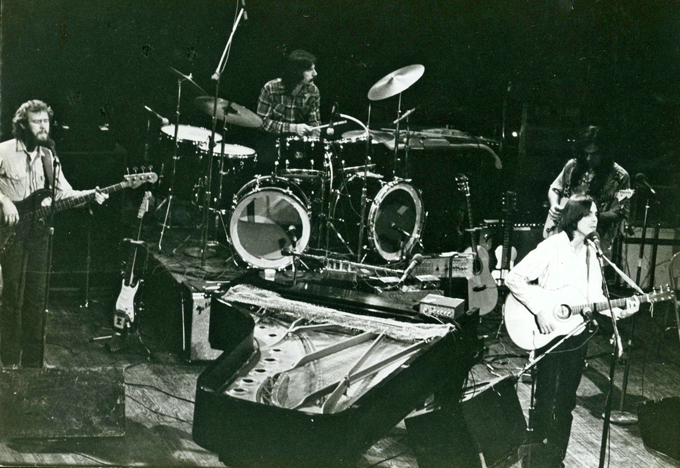
Jackson Browne (at right). Photo by Milo Beaver, courtesy Al Bjerke
Roy M. Close, reviewing for the Star, opined that Browne was even better in concert than he was on record. His songs, some of which have been recorded by other artists, “celebrate life and its attendant uncertainties. In many there’s a strain of fatalism, an expressed awareness that whatever else may be on the road ahead, death is at the end of it.”
Close said that Browne displayed a dry wit and strong sense of irony, and although his singing was unremarkable, he was sure of himself at all times.
Backing him up were Doug Haywood (bass and vocals); David Linley (fiddle, guitar, pedal steel); and Larry Zack (drums)
Michael Anthony of the Tribune termed the genre of the evening California country. His assessment of Browne tracked that of Close: “His voice is anemic, his guitar and piano accompaniment no more than apt (ept?), so it’s the songs that attract the fans, I presume. His real forte is a kind of easy-going, engagingly crafted ballad, usually autobiographical, with sources in both the country and folk tradition … The melodies are finely spun and the lyrics wistful.”
Linda Ronstadt
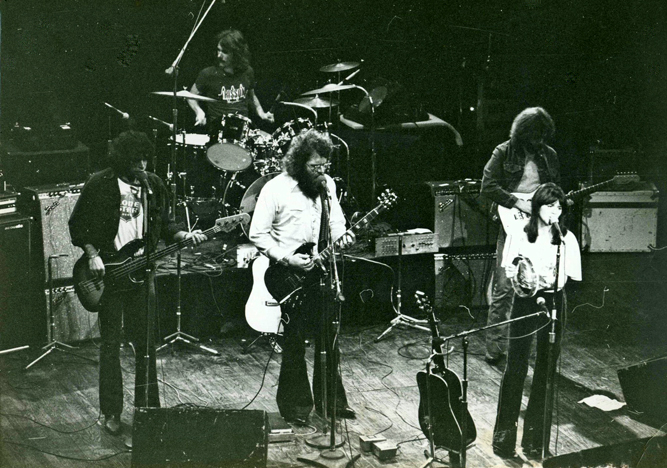
Linda Ronstad – photo by Milo Beaver, courtesy Al Bjerke
Close’s review spent a lot of ink on Ronstadt’s performer, calling her “an interesting but not extraordinary interpreter who could be the next Patsy Cline – but isn’t yet.” Close felt she was influenced by Cline in that she sang Cline’s “I Fall to Pieces,” although she had to transpose the song up an octave. She “is blessed with a strong, clear, flexible voice that resonates with feeling.” Unfortunately, excessive over amplification of her voice and the band proved to be an annoyance, and she would have been able to fill the hall without electronic help, wrote Close.
As did Close, Anthony mentioned Ronstad’s attractiveness. He also felt that the ensemble was over-amplified.
MILES DAVIS
Miles Davis was back with two shows on February 5, 1974, presented by the Walker. Neither of the shows were sold out.
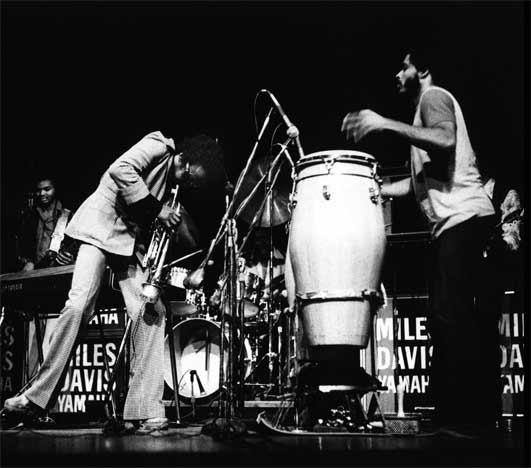
Miles Davis photo courtesy Walker Archives
Roy M. Close, reviewing for the Star, was thoroughly disappointed in the direction Davis was going by becoming more electrified and rhythm-oriented. He said that Davis’s last Guthrie show “suggested that he was no longer the exciting, stimulating performer he had been for more than two decades.” This show suggested to Close that Davis was “no longer even making interesting music.” He eventually walked out of the first show.
His playing has utterly lost its eloquence, its shimmering brilliance and its power to move the listener’s imagination. It is now tuneless, toneless, and (literally) painfully loud screeching over the din produced by six able but deplorably overamplified sidemen. In essence, Davis has turned his trumpet into an electronic percussion instrument capable of delivering tremendous volume at the expense of almost every other musical quality. Even phrasing is no longer possible under these circumstances, so Davis uses a wah-wah pedal to outline phrases … a poor substitute for the lip.
Most of Davis’ solos were staccato blasts in the upper register of his instrument. Occasionally he moved to the organ, which he played lethargically with his right hand while continuing to hold his trumpet in his left. His demeanor was, as always, cool, impersonal and detatched.
Michael Anthony of the Tribune covered the second show, and wrote that “For a lot of people, what he’s doing now is just noise.” The volume level of the 75-minute set was painfully loud. Davis blew a few notes on the trumpet then walked over to the portable electric organ and played a few dissonant chords. “Miles own playing was the biggest disappointment.” The music had “little melodic structure and quickly became repetitious.”
Sidemen included Al Foster (drums); James M’Tume (congas); Michael Henderson (bass); Reggie Lucas (rhythm guitar); and Dave Liebman (reeds).
Toward the end of the concert, everyone left the stage for a ten-minute conga solo by M’Tume. Then Davis blew three clear, plaintive notes – the Miles of old. Anthony interpreted the audience’s applause as a with for the former Miles.
STEVE GOODMAN
Steve Goodman performed on February 23, 1974, presented by the Walker. The audience numbered about 1,000.
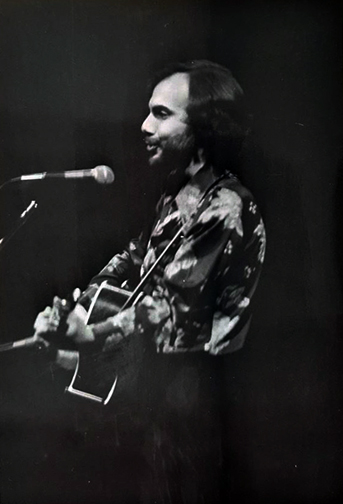
Photo of Steve Goodman courtesy Kevin Grothe
Charles Quimby reviewed the concert for the Star, calling it “nearly three of the most entertaining hours I’ve ever spent in one place.” His material of humorous songs and touching ballads ranged from wildly funny to slightly raunchy to deeply poignant, bringing sustained applause from the audience.
Local favorite Leo Kottke made a surprise appearance to accompany Goodman for numerous encores.
BOBBY SHORT – No Evidence
Jazz singer Bobby Short was listed as performing on February 24, 1974, on the Walker list but there were no ads in the newspaper to be found, nor any reviews, which would be strange if such a big star had come to town. A look at the file in the Archives shows notes of confirmation, but no documentation of cancellation.
DAVID STEINBERG
David Steinberg, with Peter Yarrow, performed two shows on March 4, 1974.
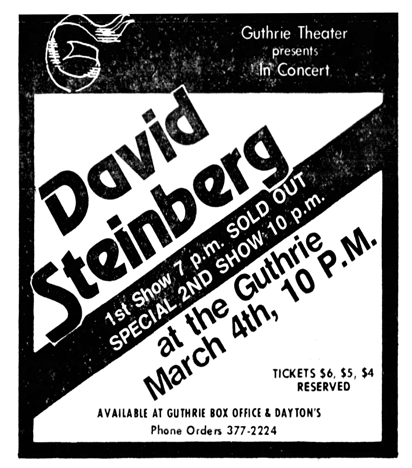
Minneapolis Tribune, March 1974
Charles Quimby reviewed the show for the Star. Steinberg’s humor centered around politics, sexual insecurity, and television, including topics of obscenity and greed. He sang Shel Silverstein’s “Freakin’ at the Freaker’s Ball,” and answered the audience’s ovation with an encore routine about a psychiatrist “that had its good moments,” but in all “did not quite measure up to the quality of a generally funny evening.”
GARRISON KEILLOR
Local humorist and writer Garrison Keillor taped three radio shows for later boradcast on KSJN at the Walker Art Center on Sunday, April 7, at 3, 5, and 7 pm. The tapings were in the Art Center Auditorium
Featured with Keillor in the programs were the West Bank Trackers, Vern Sutton, Bill Hinkley and Judy Larson, the Herrick Family Quartet and the Wolverines. The three radio shows were:
- The Lake Wobegon Academy of Song faculty recital and seminar at 3 pm;
- Faded Photos-Parlor Songs and Old-Time Jazz at 5 pm; and
- Jack’s Anniversary Dance at 7 pm.
(Press release No. 61 dated March 29, 1974, from Walker archives)
ADVENT OF GUTHRIE BOOKING
The Steinberg show was the first concert booked directly by the Guthrie’s management. Most of the shows up until now had been booked by the Walker Art Center. A few months later, on April 8, 1974, Roy M. Close of the Minneapolis Star noted that the Guthrie had established a working relationship with promoter Richard Shapiro of Greathall Corp. Shapiro booked Steinberg and following programs by the Electric Light Orchestra, Melissa Manchester, Return to Forever, and Robert Klein.
Close wrote that the new policy seemed likely to increase substantially the number of non-theatrical events at the Guthrie, especially during the four months that the Guthrie was dark. But he also wrote that the new policy has alarmed the Walker’s coordinator of performing arts, Suzanne Weil, because it apparently altered a longstanding, unwritten agreement between the new neighboring institutions that the Walker would not compete with the Guthrie by not booking theatrical events and the Guthrie would not book musical attractions. The only exception was the three concerts by John Denver in 1971.
Guthrie Managing Director Donald Schoenbaum said the new policy was not intended to put the Walker and the Guthrie into competition, but to put the theater into maximum use, bring a varied program to the public, and to make money for the theater. He said he had been given a free hand to approach any attraction he felt would be profitable, provided that he could not attempt to outbid Suzanne Weil.
The system was not perfect. Weil said she first heard of the new policy when she tried to book Melissa Manchester, only to find that she had already been contacted by Shapiro and had agreed to appear in the Guthrie-sponsored series.
DUKE ELLINGTON
Duke Ellington and His Orchestra performed three shows on March 15, 16, and 17, 1974. These were rescheduled from the cancelled January 19-20, 1974 dates.
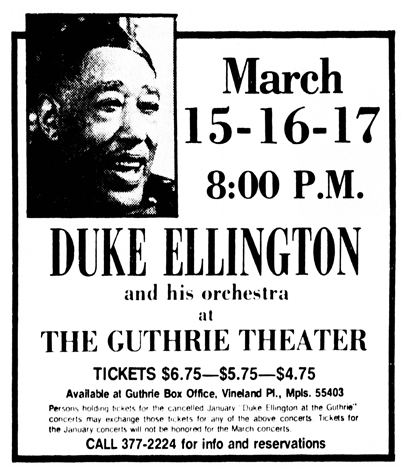
Minneapolis Tribune, February 1974
Roy M. Close, reviewing for the Star, stated that Ellington no longer gives concerts, but conducts retrospective exhibitions and events. At 75 his voice was no longer vibrant and he looked tired, but he remained an “urbane, witty master of ceremonies, and excellent pianist and bandleader, and a brilliantly versatile and imaginative composer.” By 1974 the band had lost key members Johnny Hodges, Billy Strayhorn and Jimmy Hamilton.
The first of three concerts drew a near-capacity crowd of mostly middle-aged fans who gave him a standing ovation as soon as he reached the stage. The second set featured singers Anita Moore and Tony Watkins. The reed section was made up of Paul Gonsalves, Harold Ashby, Harold Minerve, and Russell Procope.
McGUINN – JENNINGS
Roger McGuinn, with Waylon Jennings, performed two shows on March 31, 1974. The first show’s audience numbered 1,300 and the second about 1,000.
Roger McGuinn
According to Peter Altman’s review in the Minneapolis Star the next day, McGuinn was so bad that one-third the people walked out of his first show. Vocally it was disatrous – gratingly adenoidal. Instrumentally and technically it was very bad – his PA system buzzed and caused constant distortion. His playing of acoustic guitar, banjo, electric guitar was spotty. The banter between songs was puerile. “Heaven knows how McGuinn thought things were going last night.”
Michael Anthony, reviewing for the Tribune, didn’t even mention McGuinn in his headline, saying that he should have gone on first. Jennings was so good that the audience had a hard time focusing on the main act. McGuinn kept his show to half an hour and one fast encore, and seemed a bit ill at ease in the situation. The audience dwindled, and McGuinn bowed graciously and left.
Waylon Jennings
Altman did like opening act Waylon Jennings, calling his performance “a lovely, relaxed, country-and-western hour featuring five side-men including Ralph Mooney, a superlative pedal steel guitarist. He was a crowd-pleaser: when he stopped after three encores, the crowd wanted more. Altman recommended that the Guthrie have Jennings back for his own show, and they did have him back right quick.
Anthony’s review was mostly about Jennings and his band, the Waylors. He reported that despite his nasty cough, his 70-minute set was a delight. He called it country music with rock instrumentation, as opposed to the country-rock of the mid and late ’60s.
TEEN CORPS BENEFIT
On April 7, 1974, the Minnesota Teen Corps rented the Guthrie to hold a benefit concert. Performing that day were some of the area’s most prominent local musicians.
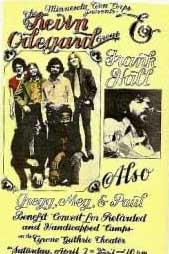
Event poster courtesy Kevin Odegard
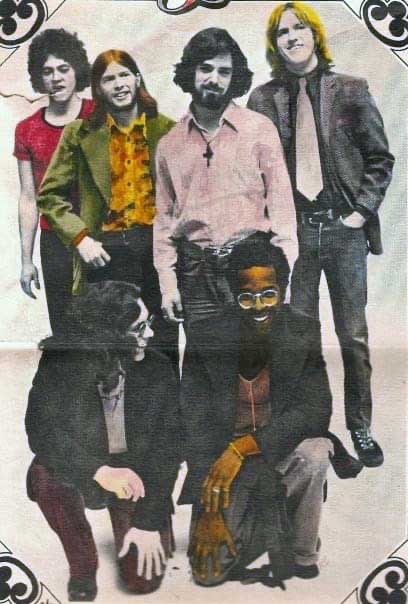
Poster detail courtesy Kevin Odegard. Pictured are Larry Wiegand, Kevin Odegard, James T. Plattes and Mark Bickerton. Kneeling are Gregg Inhofer and Stanley Kipper
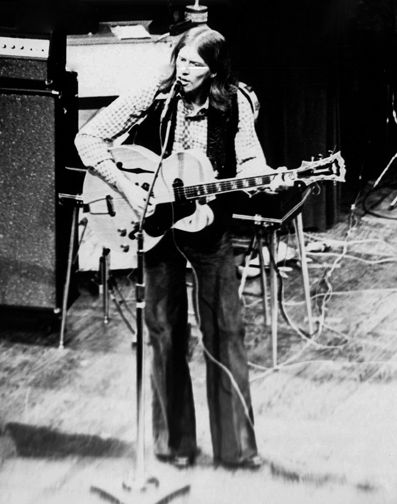
Kevin Odegard at Benefit
ELO
The Electric Light Orchestra, with Chi Coltrane, performed two shows on April 16, 1974.
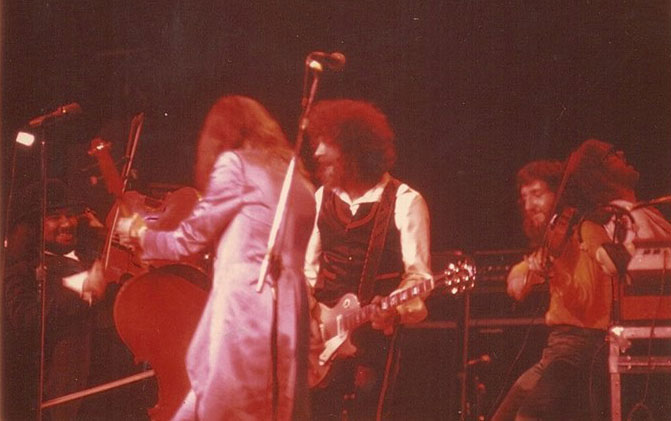
Photo of ELO courtesy Steve Klemz. Mike Edwards, Hugh McDowall, Jeff Lynne, Mik Kaminski and Mike de Albuquerque.
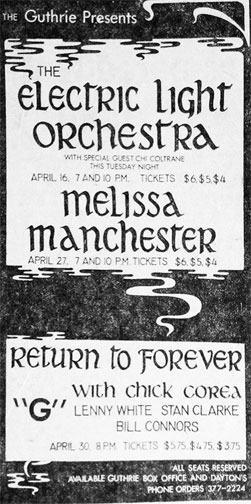
Ad courtesy Jim Froehlich
HARRY CHAPIN
Harry Chapin performed two shows on April 26, 1974, presented by the Walker. The audience was about 750 for the first show and the second appeared to be no larger.
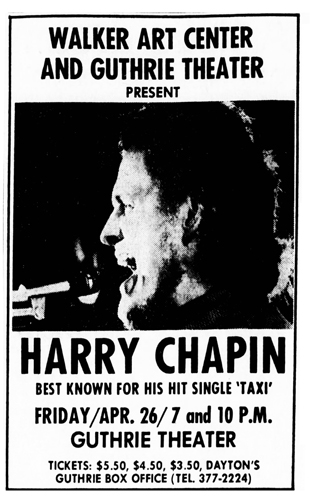
Minneapolis Tribune, April 1974
Charles Quimby, reviewing the first show for the Star, wrote that Chapin mixed humor with poignant narratives for more than two hours without intermission. There were problems: his band spent too much time clowning around, and an amp and some microphones went dead for about five minutes. But the enthusiasm of the crowd was not dampened by these setbacks.
The “beer-drinking, chain-smoking sidemen” were made up of Micel Masters on cello, Ronald Palmer on lead guitar and vocals, and John Wallace on bass.
Michael Anthony of the Tribune also reviewed the first show. Chapin started out by asking the audience to consider the theater as a living room, and easily established a rapport with them. Chapin described his material as “story songs,” and some monologues, perfored sitting at the edge of the stage. These were outgrowths from his previous career as the maker of documentaries, apparently. Anthony was not a fan of the 2 1/2 hour show with no intermission, but that seemed to be his only complaint.
MELISSA MANCHESTER
Melissa Manchester, with Henry Gross, performed two sold out shows on April 27, 1974. See ad above under ELO. Presented by Greathall and the Guthrie Theather.
Melissa Manchester
Peter Altman of the Star appropriately wrote that she had star quality. Her material for the show was from her first two records. She was dressed in a loose, flowered pants ensemble in a “neo-thriftshop style.” Her four-piece band included Stanley Schwartz on keyboards, clarinet, and several other instruments.
Jon Bream, in his “R n’ R Hootchie Koo” column in the TC Express magazine (July 1, 1974), also used the term “star quality” to describe Manchester.
Henry Gross
Altman was brutal when he called Gross an:
unadvertised, uninteresting hour of bugglegum rock by a band led by Henry Gross. I hope this was not indicative of production-control standards in future Guthrie-sponsored concerts. Walker’s series has accustomed us to better.
Gross was a founding member of Sha Na Na, and in 1974 he was a solo performer promoting an LP. He released “Shannon,” about the death of Carl Wilson’s dog, in 1976.
RAY AND GLOVER
Dave Ray and Tony Glover performed two concerts on April 28, 1974, presented by the Walker. Their former partner, John Koerner was living in Denmark at the time. The first was sold out.
Roy M. Close of the Star found Ray “no longer as exciting a performer,” but he still had his dazzling skill on the 12-string guitar, and his voice and enunciation had improved considerably with age. Glover’s harmonica “less biting and shrill than it used to be,” but he suggested that Glover had found smoother and more subtle ways of communicating through his instrument.
Close reported that the program consisted mainly of blues. They were very attuned to each other, anticipating one another’s tempo and volume changes precisely. There was very little banter between songs. They received a long, loud ovation when the concert was over.
CHICK COREA – RETURN TO FOREVER
Chick Corea and Return to Forever performed on April 30, 1974. See ad above under Electric Light Orchestra.
John Gunter reviewed the concert for the Star and found it to be very musical and exciting. The house was full – and young. He described the music as:
a tapestry, rich with contemporary jazz, rock, classical and above all, Latin strands, woven together so well that generic musical categories became meaningless. Most of the numbers played were Corea’s own compositions.
Musicians were Corea on electric and acoustic piano, Stan Clarke on bass, Lenny White on drums, and Bill Connors, guitar.
The story has it that the group’s equipment was stolen before the show, and they had to borrow instruments from local musicians. Stan Clarke used Doni Larson’s bass, so they say…
JAMES TAYLOR
James Taylor performed two shows on May 1, 1974, presented by the Walker.
Michael Anthony reviewed the first show for the Tribune, and wrote that there were no real surprises. As always, he found him to be a disarming, unassuming performing. He started with a couple of solo tunes, then brought out his five-piece band in groups of two and three. Anthony heaped special praise on bandleader-guitarist David Spinoza, who “combined inventiveness with a jazz sense of economy.”
The surprise came at the end of the show, however, when JT walked offstage and brought on his wife, Carly Simon, who was traveling with him and their four-month-old daughter. Minneapolis was the second stop on this bus tour. The audience let out a “shriek the size of a sonic boom” and Taylor and Simon sang their hit, “Mockingbird” and did a little slow dancing during an instrumental chorus. They walked offstage to another sonic boom, and then Taylor came back for an encore of “Sweet Baby James.”
Jon Bream, in his “R n’ R Hootchie Koo” column in the TC Express magazine (July 1, 1974), noted that Taylor was promoting his forthcoming album “Walking Man.” The tour started in Moorhead, Minn., of all places! In Bream’s article, the daughter was five months old and had a name – Sarah.
HERBIE HANCOCK
Herbie Hancock, with Graham Central Station, performed two sold out shows on May 6, 1974, presented by the Walker.
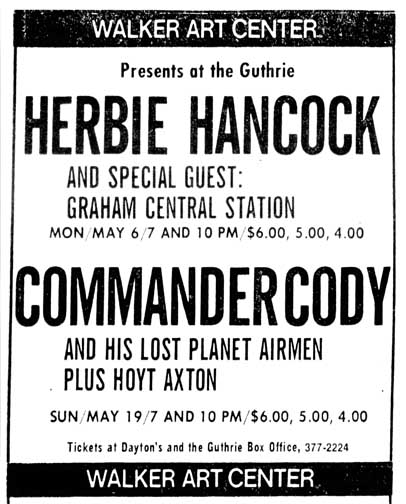
Minneapolis Tribune, April 1974
Herbie Hancock
Musicians were Hancock (keyboards – electric piano, Clavinet, ARP synthesizer); Bennie Maupin (saxello, tenor sax); Mike Clark (drums); Bill Summers (West African percussion instruments); Paul Jackson (bass).
Michael Anthony reviewed the second show for the Tribune and clocked the show at 75 minutes. The review was fairly technical, and listed some of the songs performed.
The only low point in the set, in fact was the end, a cataclysmic coda featuring Hancok on sythesizer (an ARP Soloist, I think), which seemed more noise than anything else. ut it certainly brought the evening to a smashing close.
John Gunter reviewed the first show for the Star, and found Hancock’s hour enjoyable.
Dan E. posted this tale on Facebook:
Herbie Hancock told an amazing story about his concert at the Guthrie in the early ’70s. Some drunk guy in the cheap seats climbed up on a rafter, crawled on it all the way to the area above the stage, and then dropped down on HH. Nobody got hurt though.
Graham Central Station
Anthony had pretty good things to say about Larry Graham’s outfit, calling them what used to be called a “show band.”
Their big finish, a de rigeur tells-it-like-it-is ghetto number, worked to a thunderous climax – the spotlights criss-crossing the stage like searchlights, the guitars playing like machine guns – succeeded in getting a good portion of the audience up and hopping in front of their seats, as instructed. At the Apollo Theater in New York City, I would imagine, everybody gets up.
Gunter found the band to be a “disastrous warmup act” that “slammed the half-filled house (Anthony said they were both full) into a catatonic state.”
The music was loud and out of tune, the tempos dragged monotonously. There were flashy costumes, physical gymastics, and spotlight effects likethose seen at a service station opening. The group’s only real asset was Patryce “Chocolate” Banks, whose voice cut through the din at times to reveal a clarity sadly missing from the rest of the act.
Jon Bream, in his “R n’ R Hootchie Koo” column in the TC Express magazine (July 1, 1974), reported that the band was named for Larry Graham, who was an integral part of Sly and the Family Stone for seven years. Instead of having Sly’s reputation for not showing up, Graham had a hard time sticking to its 45 minute opening act time limit. This Guthrie show lasted an hour. Bream, too, singled out Banks as an outstanding vocalist.
Bream pointed out one mess the group was in: Their agent had booked the band to appear on May 16, 1974, at O’Shaughnessy Auditorium at St. Catherine’s University in St. Paul, only 10 days after the Guthrie shows. Most acts won’t come ack to the same market for at least 30 days, and there are usually riders in their contracts with this stipulation. When this was pointed out to the agent, she asked, “Is St. Paul in Minnesota? Oh, I guess it is. Well, where is it?” “Across the river from Minneapolis.” “Oh.”
ROBERT KLEIN
Robert Klein isn’t a musician but hip comedians count here. He made us laugh on May 17, 1974. Says here it was his first appearance in the Twin Cities.
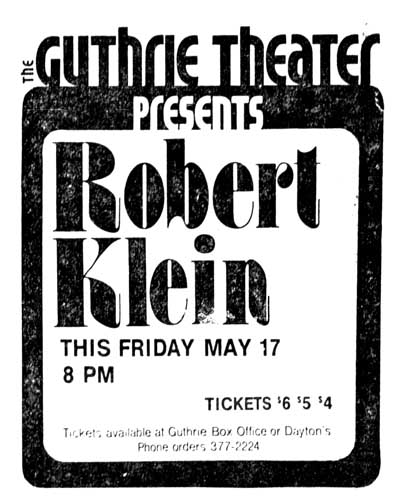
Minneapolis Tribune, May 1974
COMMANDER CODY
Commander Cody and His Lost Planet Airmen, with Hoyt Axton, performed two shows on May 19, 1974. See ad above under Herbie Hancock, May 6, 1974.
Commander Cody
Charles Quimby, reviewing the show for the Star, wrote that Cody and the seven Airmen “flew through a variet of styles in their half of the concert, including a fox trot and a blues done in a big band manner.” Cody’s signature repertoire was country tunes infused with rock, and 1950s style rock rock done ine in a country style. The performance was enthsiastically received by a raucus crowd, some dressed in cowboy style. During the two encores, several dozen people broke into the aisles to dance.
The band was made up of Cody (nee George Frayne) on barrel house piano and vocals; Billy C. Barlow, singing the rockers; Bill Kirchen and and John Tichy on guitar and the country vocals; and Ernie Hager on pedal steel, recently replacing Bobby Black.
In his review in the TC Express, (June 3, 1974), Jon Bream described Cody’s music as:
90 minutes of rousing rock ‘n’ roll, rockabilly, boogie woogie, longhair country and truckers delights, or more precisely: Ozone music. The band was tight and slick but uninspired The steel guitar work of recent addition of Ernie Hager was particularly heart-warming.
Bream was upset about the hundred or so people who “filled the narrow area between the seats and the stage – and often climed on the stage – dancing and generally having a good time, but to the detriment of many other paying customers.” Fun is fun, until it infringes on the rights of others.
Hoyt Axton
Quimby described Axton’s music as “hard-bitten.” He was backed by two women singers, a male vocalist-harp player, and four others. Although Axton had been a phenomenal songwriter (“Greenback Dollar,” “Joy to the World,” “Never Been to Spain”), Quimby found he had a powerful but undisciplined voice, which he likened to nails in a pepper grinder. He also was put off by his lack of stage presence, saying he looked like a derrick hand pulled out of the Texas oil fields. The backup group strongly compensated for his flaws, opined Quimby, and made for likeable music.
Bream deemed Axton’s set warmly-received. “It was the most entertaining set by a group with a non-singer lead vocalist I’ve seen in a long time.” As usual, Bream had some afterstory: “Backstage between sets, young Cody was giving the veteral Axton some pointers as the legendary Ramblin’ Jack Elliott listened in.”
JESSE COLIN YOUNG – JANIS IAN
Jesse Colin Young, with Janis Ian, performed two shows on May 26, 1974, presented by the Walker.
Jesse Colin Young
Jon Bream reviewed the first show for the Star, which lasted 80 minutes and was sold out. Young’s four man band included Young on acoustic and electric guitar, Scott Lawrence on piano, and Charlie McCarthy on horns. But despite skillful musicianship, the concert became almost tedious because of Young’s manner was too low-key to maintain such a long set.
Janis Ian
Bream wrote that Ian’s opening set was marred by inconsistency. Her personal material was engaging but lacked stylistic focus, as she sang folk, rock, blues, country, protest songs, and a couple of humorous tunes. The hig point was her performance was her lengthy and affecting autobiographical song “Stars,” about the awkward experience of teenage stardom, which whe experienced in 1966 with her hit “Society’s Child.” Her set was well-received, and the audience demanded a rare opening-act encore.
MICHAEL JOHNSON
Michael Johnson performed two shows at his second solo appearance at the Guthrie on June 9, 1974, presented by the Walker.
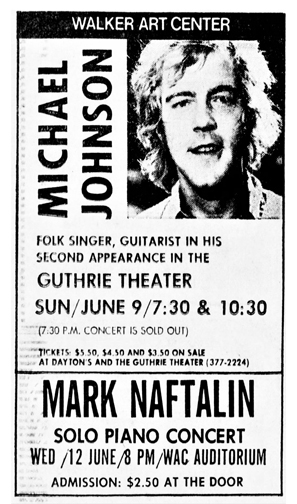
Minneapolis Tribune, June 1974
Roy M. Close, reviewing the first show for the Star, called Johnson an an interesting performer but not an exciting one. He began with 90 minutes of solo work,whichsshowed a preference for message-heavy songs and an undistinguished (although pleasant) voice.
For the last half hour, he brought on two sidemen: Mark Henley and Ted Sherman. Close called the difference “astonishing.” Polite applause was replaced by long, loud ovations for music full of energy rather than attention to detail.
SARAH VAGHAN
The Sarah Vaughan Trio, with the Wolverines, performed two shows on August 18, 1974, presented by the Walker and the Guthrie Theater.
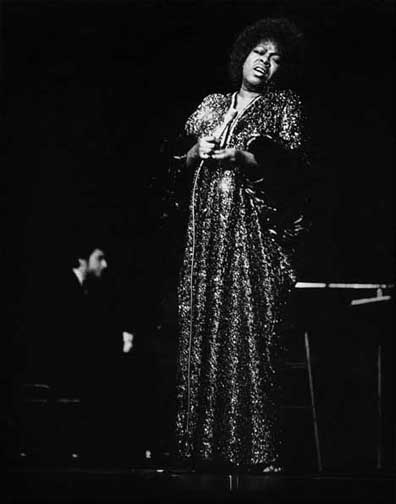
Photo by Boyd Hagen – Walker Art Center Archives
Sarah Vaughan
John Gunter, reviewing for the Star, reported a middle-aged and enthusiastic full house, and declared Miss Vaughan one of the best vocal stylist this country has ever produced. Her musicians were Frank Delarosa on acousic bass, Jimmy Cobb on percussion, and Carl Schroeder on piano. Her encore to a standing ovation was a medley of ballads highlighted by “Body and Soul.”
In short, Miss Vaughan was magnificent. She san fast and slow, low and high, and loud and soft, and, although professional, she never once sounded slick – she simply sounded like a great American singer.
Michael Anthony of the Tribune reviewed the first of the two shows and reported that she was given two standing ovations. And that caftan in the picture above is a shimmering gold!
The Wolverines
Anthony reported that the first set was opened by a local Big Band of 14 members called the Wolverines, led by Ted Unseth, who specialize in the performance of classic jazz, especially of the 1920s. He gave them marks for considerable skill, called them great fun to hear, and urged people to hear them in their later appearances around town.
OZARK MOUNTAIN DAREDEVILS
The Ozark Mountain Daredevils, with Ted Anderson, performed at the Guthrie on September 29, 1974, presented by the Walker.
Ozark Mountain Daredevils
Roy M. Close, reviewing for the Star, called the Daredevils solid but unexciting – he wrote that the most interesting thing about them was their name. They played a 70 minute set that gravitated toward rock, with occasional bows to country and a slight nod to the blues. The drums were inflexible and had no appealing alternative to their basic formula, repeaing the same song over and over again, with the same arrangements but with different lyrics and melodies.
The band members included Randle Chowning on guitar, who formed the group 2 1/2 years ago; John Dillon, and Steve Cash on harp.
Ted Anderson
Close’s review of opener Ted Anderson, was brutal in its disinterest, calling him a young Wisconsin singer-guitarist who delivered a dull 30-minute set.
RANDY NEWMAN – RY COODER
Randy Newman, with Ry Cooder, performed two sold-out shows on October 6, 1974, presented by the Walker.
Randy Newman
Michael Anthony’s review for the Tribune called Newman’s delivery laconic and deadpan, singing in a voice that Henny Youngman would describe as the mating call of a pair of corduroy pants. His themes included religion, politics, nostalgia, relationships, and sexual frustration. Many came from his newest album, “Good Old Boys.”
Jon Bream, reviewing the second show for the Star, called Newman perhaps America’s best contemporary songwriter. Newman played nearly two dozen songs in an hour, often cutting songs short by a verse or two. He noted that “Good Old Boys” was a concept album that explored the cliches and legends of the South.
Ry Cooder
Anthony explained that Cooder was a session guitar player, and his vocal material consisted of old blues material, which carried conviction and humor. He played guitar and mandolin, and his bottleneck style can be heard on the Stones’ recording of “Love in Vain.”
Bream noted that Cooder opened the concert with an enjoyable set of blues and folk songs, and concurred that he was an accomplished guitarist.
LOUDON WAINWRIGHT III
Loudon Wainwright III, with David Loggins, performed two shows on October 20, 1974, presented by the Walker. The opener was originally announced as Doug Sahm.
Wainwright
John Bream, reviewing the first show for the Star, wrote that although Wainwright had released a hit song and four critically acclaimed albums, he remained little more than a cult figure. The Guthrie was half filled for the first show. He was a less than accomplished guitar player, an unremarkable singer, but an ingenious songwriter, and a masterful live entertainer, Bream wrote. He excelled in black humor, and came off as a poet in the middle of a two-week drunk. Much of his material came from his upcoming album, “Unrequited.”
Dave Loggins
Bream deemed Loggins’ 50-minute opening set as mediocre, with original and borrowed material. He was a pleasant enough singer (his hit was “Please Come Home to Boston”), but the performance was more appropriate for a coffee house or a college gym than a concert hall, Bream opined. Dave Loggins was no relation to Kenny Loggins.
Maria Muldaur was first scheduled to appear at the Guthrie on October 27, 1974, presented by the Walker. Then the concert was moved to the new Orchestra Hall. Finally the concert was cancelled altogether because of illness in her family.
TOM PRIN
The Tom Prin Trio with Penney Perkins performed a benefit for the American Diabetes Association of Minnesota on November 24, 1974. The show was introduced by TV personality Charlie Boone. A segment of the show was devoted to the words and music of Twin Cities songwriter Bob Williams.
Pianist Tom Prin is the son of TV personality Toby Prin. The rest of the Trio consisted of Clyde Anderson on bass, and Richard Lavay on drums. Penney Perkins was a vocalist from Bloomington.
WAYLON JENNINGS
Waylon Jennings, with Tracy Nelson, performed two shows on November 3, 1974, presented by the Walker.
Waylon Jennings
Peter Altman of the Star, reviewing the first show, reported that the audience came decked out in boots and hats for this, Jennings’ first starring appearance at the Guthrie, after appearing as an opening act on March 31, 1974. The first show was delayed somewhat because of some airport difficulties from Nashville, but to compensate he played for 75 minutes with four encores. There were seven members in the band, who included Ralph Mooney on pedal steel.
Tracy Nelson
The opening act was Tracy Nelson, who performed for 45 minutes with five sidemen. Altman described Nelson’s music as a rock style much influenced by the blues. She hadn’t quite found her niche, but had a strong clear contralto voice and could really whip up excitement. Nelson also played a “meaty and driving” piano.
KOERNER, RAY, AND GLOVER
Koerner, Ray and Glover made an appearance on December 8, 1974, presented by the Walker.
KEITH JARRETT
The Keith Jarrett Quartet performed to a full house on December 22, 1974, presented by the Walker.
Michael Anthony’s review for the Tribune (December 25, 1974) revealed that this was the final event in Jarrett’s five day Twin Cities visit, the first four of which were in St. Paul Chamber Orchestra programs.
The Quartet consisted of Jarrett on piano and soprano sax, Dewey Redman on tenor saxophone, Charlie Haden on bass, and Paul Motian on drums. The Quartet was not a permanent unit, each prominent jazz players in their own right, with their own ensembles and others.
Anthony opined that the event
spotlighted the straight-ahead but marvelously evocative jazz that first brought Jarrett his fame. [But while many of the contemporary jazz figures had drifted off into the land of electronic noise (and that dreadful little instrument, the electric piano),none of them can touch Jarrett for technique or for the mystery and beauty of Jarrett’s art.
With the opening of the new Orchestra Hall in 1974, with a seating capacity of almost 2,100, many acts that had been appearing at the Guthrie were now booking at the newer, larger facility.
(A reminder that this website stops at 1974.)
A new multistage Guthrie theater center on the banks of the Mississippi River opened June 25, 2006.
SOURCES
Several lists of Guthrie concerts have come across my desk, and my task has been to figure out which ones to post, which ones are real, and which ones are missing.
My first list may have come in 2013 from General Manager James D. Scott – a list he found when he took over his position. It looks like it had been typed on a typewriter, and some very critical pages from 1968 were missing, but interestingly enough, it did include the fees paid to the performers and the income realized.
Someone else obviously sent me the program covers, and I’m ashamed to say that I have no recollection of who that person was. They have been sitting on my computer waiting to be posted for a very long time, and I thank you!
Then there is a thick document entitled “Walker Art Center Presents – All Events,” but there are concerts on here that we can’t find anywhere, and I will designate those as “Unconfirmed.” I’m sorry but I don’t know where this list came from.
The Walker Archives also has lists of events on its website, and I thank its curator for guiding me to those resources. I actually hope to explore those resources further by looking at the individual files of concerts that are questionable.
Now comes Mitch Baird, who – out of the blue – sent me an awesome spreadsheet (who says “awesome spreadsheet?”) of performances at the Guthrie through the years! Mitch has been the production manager of concerts at the Guthrie since about 1984.
The penultimate source of information is the newspaper, and with newspapers.com I can bring up ads and reviews.
With all this information there were still holes, and I thank Walker Art Center Archivist Jill Vuchetich for pulling and allowing me to look through the files of the concerts that were cancelled or that never seemed to have happened.
Add to that the photos of the concerts themselves, especially those so generously provided by the premiere photographer of the 1960s and ’70s, Mike Barich, and we have a glimpse into those great days when we could see our favorite stars in an intimate setting.
I am proud to add Suzanne Weil to the list of people who have reviewed this document and provided information on her most important role as Performing Arts Coordinator.
There’s always room for more memories, stories, and pictures, so please don’t hesitate to contact me if you have corrections, additions, photos, or whatever. Thanks!
992 Arcade Street, St. Paul. Sam “Gus” Guzzo bought the place in 1954. He died in 1958 and his wife Alvina ran it until she sold it in 1963. Dancing on Friday and Saturday nights. Photo below from 1957-58 posted on Facebook by Connie Guzzo Winterhalter.
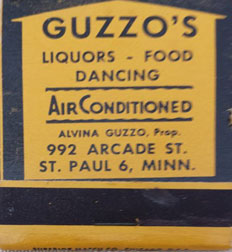
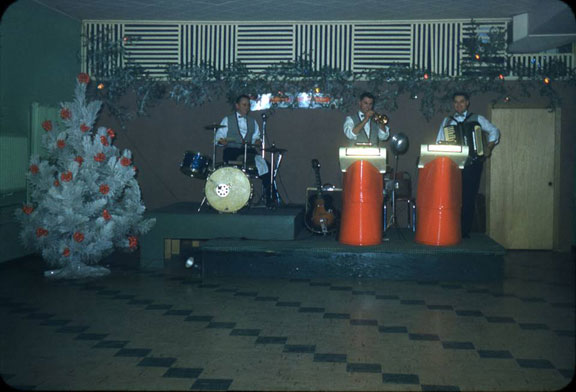
Guzzo’s 7th Street Cafe, 7th Street and Broadway in St. Paul, was apparently a precursor to the Guzzo’s above. The photo below is from 1939, also from Connie Guzzo Winterhalter.
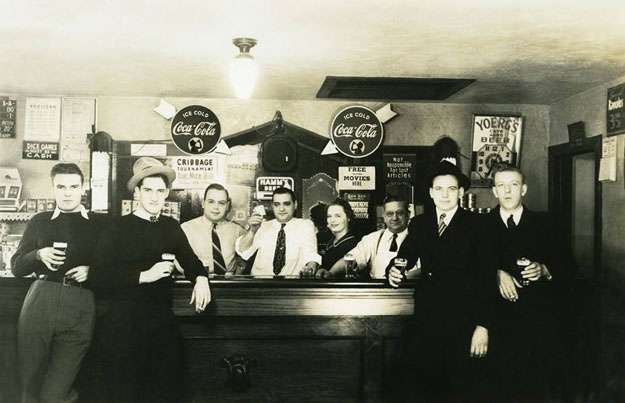
Hafner’s was located at 1560 White Bear Ave., at the south end of the Hillcrest Shopping Center in St. Paul.
HILLCREST BOWL
At first the facility consisted of a basement bowling alley; in 1959 the upstairs was built. There were bowling alleys on both floors. According to the lighter below, there was a cocktail lounge with a piano bar.
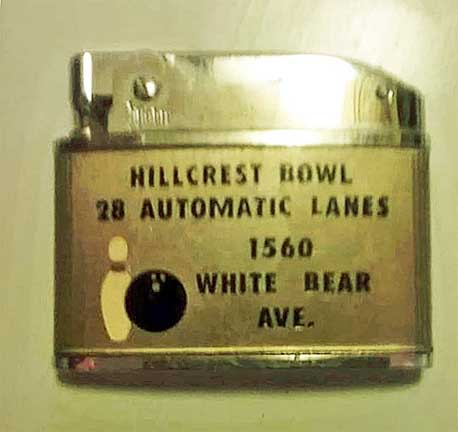
Photos of lighter courtesy of Diane Humphreys
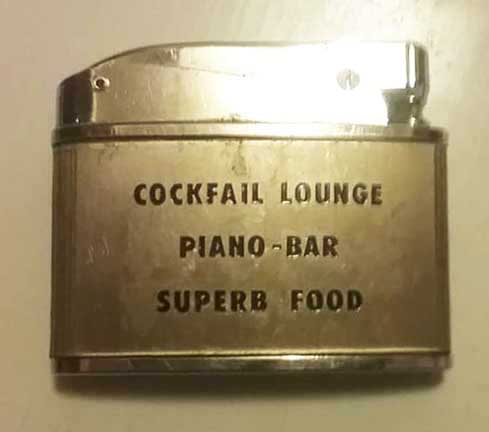
HAFNER’S RESTAURANT
The name of the facility was changed to Hafner’s in 1965, although it belonged to the Hafner family before that.
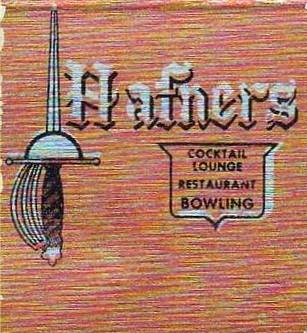
Courtesy Ron Ciccone
The facility served as the venue for many events for the 3M Corporation.
The Lord Aldon Room was named for its owners, brothers Al and Don Hafner.
1974: Always the finest in dining and entertainment. Jim Harvey at the organ. Now playing in the Lord Aldon Inn: Skyline. In the Rumpus Room: Ken Nelson.
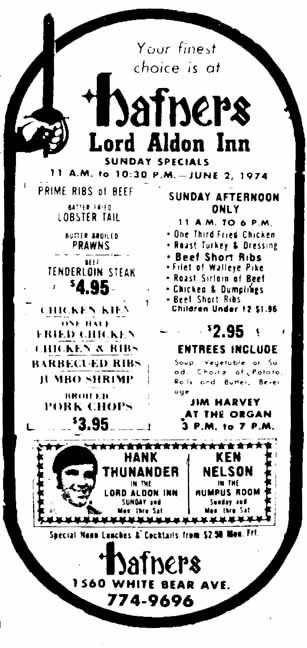
June 1974
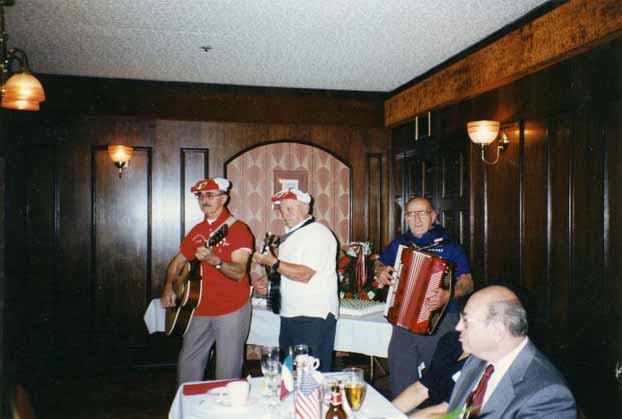
The Sanchelli Brothers (Joey, Mikey, Noah, Gerry Hurd) at Hafner’s, 1988 – Minnesota Historical Society
DRUG CHARGES
On August 12, 1994, Hafner’s owner Carl L. Thompsen pleaded guilty to conspiracy to distribute marijuana and money laundering. He and 22 other people, including NHL hockey player Thomas McCarthy were indicted in March for their involvement in a network that brought marijuana and cocaine from South America to California, then to St. Paul and Mankato. Thompsen allegedly gave McCarthy two pounds of marijuana for driving 150 pounds of marijuana from California to Minnesota. The others either plead guilty or stood trial at the end of the year. Thompsen had been granted a liquor license in 1991 despite having a cocaine-related conviction. The shipments of drugs were alleged to have happened in 1989 and 1992. (Minneapolis Star Tribune, August 13, 1994; November 18, 1994)
In 1995 Hafner’s Restaurant became Hafner’s Sports Bar.
HILLCREST BOWLING AND ENTERTAINMENT
In February 1998 it was listed as Hillcrest Bowling and Entertainment Centers in the Star Tribune calendar of events.
The company that owned the facility, which had a number of names (including “formerly known as Hafner’s”) filed Chapter 11 bankruptcy on July 19, 1999. The president of the company was Charles Senkler.
The facility continued to operate, with Charlie’s Bar, a banquet hall, and the bowling alley, run by Senkler. On August 12, 2000, a white malcontent made racial slurs towards black participants at a rehearsal dinner, and the fight escalated until the suspect got in his van and aimed it at the victims. He seriously injured two bridesmaids and sent them to the hospital. (Star Tribune, August 13, 2000)
DEMOLITION
The entire block was razed in 2002. The last mention in the Minneapolis Star Tribune of the address is in March 2003, in an RFP looking for development of the block for market rate housing. As of May 2019 no construction has occurred.
The following article appeared in the East Side Review on August 9, 2015, written by Patrick Larkin.
Hafner lot, long empty, on market: NENDC hoping flea market, food trucks will draw attention to the spot
Just south of the border with Maplewood, a bare and disheveled piece of pavement has sat empty for over a decade at 1590 White Bear Ave.
The lot once held a bustling shopping center emblematic of the strip mall format of the 1950’s, called Hafner’s. Hafner’s was a pillar of the Hillcrest shopping area along White Bear Avenue, just south of Larpenteur Avenue and St. Paul’s border with Maplewood.
Hafner’s held a bowling alley, restaurant and lounge along with several other commercial entities including a barber and a chiropractor. It was a booming mall with parking and a gas station. But slowly, business faded, in part due to changing times, suburban shopping centers, freeways, and the like. It changed owners multiple times, and the building slowly fell into disrepair.
By the time St. Paul’s Housing and Redevelopment Authority acquired the land in 2002, it was on its last legs. The city bought and demolished the place, and shored up the 2.18 acre lot for redevelopment.
Now for the first time since it was razed, the North East Neighborhood Development Company, which now manages the lot through its real estate brokerage, Capitol Brokerage, put it on the market this spring, hoping to draw in a developer to the blank spot on White Bear Avenue.
It was first listed on March 17, and according to NENDC’s Chuck Repke, it has attracted some modest amount of interest from developers, although nothing’s solidified.
To keep the site active, NENDC is allowing it to be used by two food trucks — a taco truck and a deli truck — as well as a church, which will use the lot to hold flea markets.
Mixed use possibilities
Dave Gontarek, project manager in St. Paul’s Planning and Economic Development department, said the place has been informally on the market since the HRA acquired the property more than a decade ago.
Through those years, he said they’ve heard some interest in the parcel, including a church group looking to build a restaurant, but the proposed uses didn’t add up to enough density to satisfy Hillcrest’s small area plan.
The price tag for the empty concrete lot is $1.3 million, and the purchase and development of the lot is subject to the St. Paul Housing and Redevelopment Authority’s approval.
“With that,” Repke noted, “the price becomes flexible based on how enthused the city is.
“The more positive the benefit to the neighborhood, the more likely the city is to come down on the price.”
Repke said he’s pulling for a mixed use or commercial development — a smaller grocery store like Trader Joe’s, or an apartment building with storefront retail on the main level.
However, for residential uses to be approved, the site would need significant cleanup — there used to be a Clark gas station in the front portion of the lot, which had leaky gas tanks. Those old wells would need to be removed, and soil remediation would likely be needed.
‘Heck of an enterprise’
Repke said that bringing in an anchor building to the dated shopping district would be a good way to keep the place viable.
Though vacancy rates in the commercial buildings along the corridor are low, it takes a significant amount of time to find new tenants when one moves out, he said.
The goal would be to have a store with some draw, that would make the whole corridor more active, so prospective tenants were approaching the building owners, rather than the other way around.
“I want people to see it as a retail site,” Repke said. “I figured over the course of the summer we would fill it up with things happening and draw a little attention to it.”
“There’s 19,000 cars going past that property every day,” he added. “That ought to be enough customers for almost anybody to figure out how to make a buck.”
Gary Unger, who lives just a few blocks from the site, used to pump gas at the gas station in front of Hafner’s, and also used to set pins at the lanes.
He can recall Hafner’s in it’s full glory.
“It was a heck of an enterprise,” he said, adding that the place was spick and span.
“It was the cleanest place you’ve ever seen in your life… the sanitatition around there, it was second to none.”
With the idea of a new development coming to the spot, he said he’d like to see a destination store go in.
While White Bear Avenue was once a happening commercial strip; it’s now a bit more off the beaten path, he said. He pointed out that as the suburbs flared out, White Bear Avenue connected to the Maplewood Mall, as well as the high-speed roadways Minnesota 36 and Interstate 694, which connect to various suburban shopping facilities, leaving the once bustling commercial corridor as just a connector.
Please see the Kistler Building for information about Halfway Hall.
This Dixieland venue was located in the Village of Mendota from 1966 to 1991. (Mendota became a City in 1974.)
The building had been a car painting shop.
In March 1968 it was only open on the weekends and served beer, setups, and pizza.
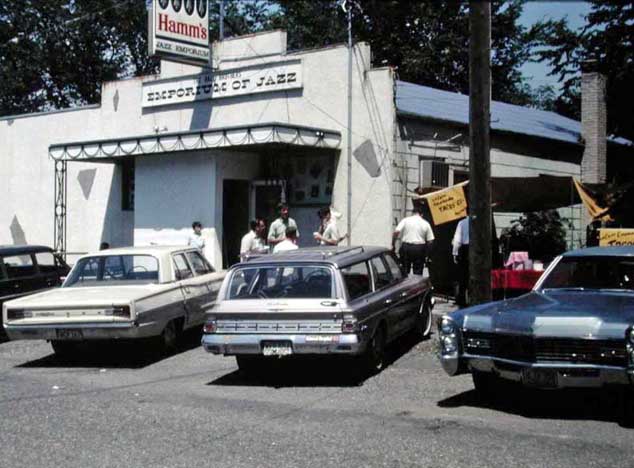
Will Shapira is quoted in the May 2008 online newsletter the Mississippi Rag:
… in 1967 I was delighted to find that the Hall Brothers had opened their own place, Doc Evans’ former club in Mendota. The Emporium of Jazz originally was a bottle club — bring your own booze and buy setups — and I remember Charlie DeVore tending bar and acting like a mad scientist during band breaks. Eventually the liquor license was upgraded and the restaurant was added, but the Emporium, with its smoke-browned ceiling, always had a loose and welcoming ambience, I thought. And, from the beginning, the Hall Brothers, Henry Blackburn, Bill Price and others not only showed us Minnesotans what real New Orleans music sounded like, but they imported many of the old musicians from New Orleans who were and some of the very best musicians in traditional jazz. That scene went on for 25 years — from 1966 to 1991 — despite fiscal distress. The band members/business partners weren’t in it for the money.
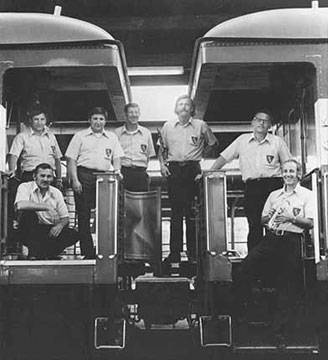
Hall Brothers publicity shot for a whistlestop tour, 1973, courtesy of the Minnesota Historical Society. L to R, Front: Stan Hall, Charlie deVore. Back: Don Andrews, Bob Andrews, Mike Pollad, Butch Thompson, Gus Hall. Names courtesy Steve Wilson!
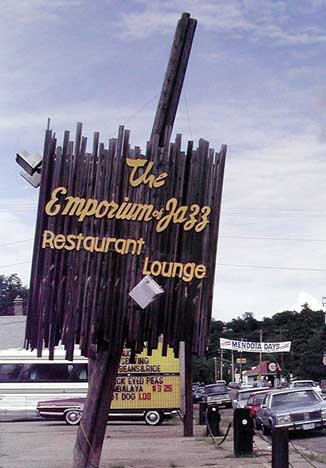
The Hall of Fame was located at 1548 University Ave. in St. Paul, in the Midway Shopping Center.
This is also the address of the Hall of Fame All Star Bowl, which opened on August 12-13, 1960. This ad is impossible to read, but it was pulled off of Facebook, with gratitude, since the St. Paul papers are not online.
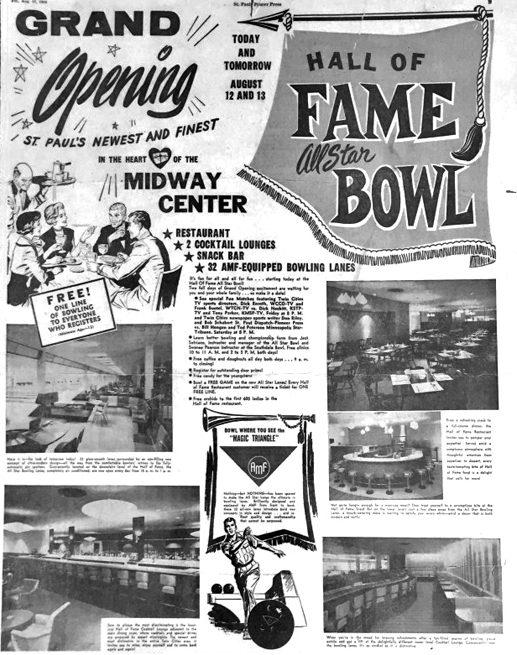
St. Paul Pioneer Press, August 12, 1960
The Hall of Fame’s first ad in the Minneapolis papers that I found was on May 3, 1963. The entertainment was the Four Belmonts, with Shari Farris and Dick Hale, who gave two floor shows nightly.
Augie Garcia entertained in December 1963 and January 1964.
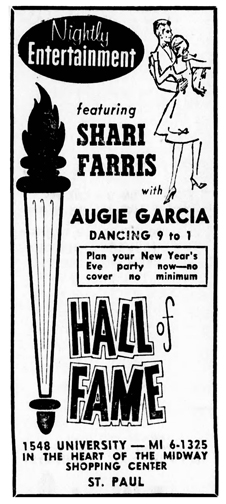
Minneapolis Star, December 28, 1963
Jerry Cole was the owner in 1964, and also an entertainer. “Password for Fun: ‘Have a Ball at the Hall'”
Ads stopped in March 1964, at least in Minneapolis, but started up again in the entertainment listings in March 1969, with dancing and entertainment nightly to the Misfits.
The venue may have lasted at least until 1974.
Please see Dick’s Horseshoe Bar.
The Hankow Cafe was located at 24-26 South 6th Street in Minneapolis.
It existed between 1914- 1925 or 1926, and was managed by Tom Lee. Tom Lee went on to help Walter C. James with the Nankin. (Tom’s son Harry Lee managed the Nankin from 1944 until the late 1980s.)
Overlooking beautiful Long Lake, Minnesota. There until at least 1976. Julianne Renner reports that “The Hanson House was the only fine dining restaurant in Long Lake for many years.” It later became Billy’s Lighthouse (the owner was named Bill Light) “and now stands there forgotten and empty and sad.”
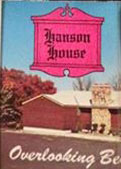
Matchbook posted by Scott Bottolene
The Happ Auditorium was a dance venue with an ever-changing name and place, according to ads. It was owned by Adam J. Happ.
The Chaska History Center says that this was the former Schnitzelbank club building, moved from up by Guardian Angels cemetery to 5th Street and Chestnut Street.
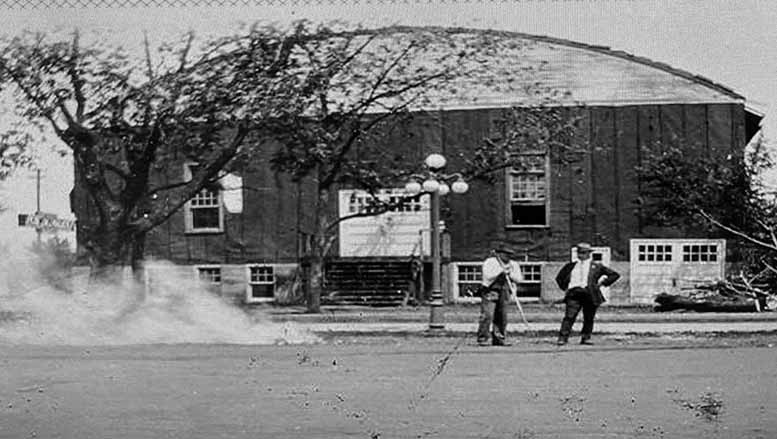
Undated photo courtesy Chaska History Center
HAPP AUDITORIUM
Although I have yet to find out when this building opened, the Chaska History Center has provided several items from the local paper that give us a glimpse into how the building was used, starting in 1924:
February 14, 1924:
The local Peptinos girls basketball team took on the fast Hook-Em-Cow girls Sunday afternoon at the Happ Auditorium and lost out by a score of 12 to 0. The South St. Paul girls were larger and stronger and the team work of the girls was a revelation. That’s where our girls fell down and from now on they should try and develop team work.
November 20, 1924:
The Happ Auditorium will be the scene of another great “Battle of Music” next Sunday evening, Nov. 23rd when the famous Al Olson’s Syncopators of Albert Lea and Dean’s Serenaders of Cresco, Iowa, play on the same floor at the same time. Manager, Dick Happ is making great preparations for this event and expects to entertain a record breaking crowd of dancers.
April 2, 1925:
The roller skating rink at the Happ Auditorium has been drawing record crowds right along. A race was the feature on Tuesday evening, being between a Mr. Casey of Jordan and a Mr. Murphy of Excelsior. Murphy won and he was immediately challenged by Walter Roy, one of our fast boys, and these speed sharks will get together at the rink this (Thursday) evening at 9:15. This should be a hot race and another big crowd is looked for.
January 14, 1926:
The famous Hurst’s Club Royal Orchestra will furnish the music for the January Dance Jubilee at the Happ Auditorium next Sunday evening. Manager Happ is making elaborate preparations for this event. Lunch and refreshments will be served in the auditorium café. A cordial invitation is extended one and all.
March 4, 1926:
Fred Charles, of St. Louis, Mo., fancy skater, will appear at the Happ Auditorium next Saturday evening giving an exhibition of fancy skating. Admission price will be 15 cents.
February 3, 1927:
The famous Brandt’s Hot Points orchestra of Wells, Minn., well-known through out the entire Northwest, have been engaged by Manager Dick Happ of the Happ Auditorium to furnish the musical program for the big dance next Sunday evening February 6th.
The first we find of the Happ Auditorium in the Minneapolis papers is a small notice placed in the Minneapolis Tribune‘s Public Announcements Section, under Amusement, on November 16, 1927. In full, it reads:
VERY SPECIAL ATTRACTION. THE BIG HIT OF THE NORTHWEST. Dance at the Happ auditorium, Chaska, Minnesota. On high. No. 12, Sunday, Nov. 20, BUICK GOLD SEAL VAGABONDS, 12 radio artists, exclusive featuring Buick master tenor. Always a crowd at Chaska, excellent floor management and good treatment at all times. Dance every Sunday. Good orchestras. Adam J. Happ, Prop.
In 1928, the Minnetonka Record advertised a dance on February 12, 1928, with music by Cliff Moody and his Minneapolis Ballroom Orchestra. $25 cash prizes were to be awarded to the town that was best represented in number at the dance.
Every surrounding town is included in this contest and as you enter you register and give the name of the town you represent. Get the Gang together, elect your officers, and make this drive your prize.
There was also an Auditorium Cafe with plate lunches for 25 cents.
March 8, 1928:
The Happ Auditorium, which is now being used for roller skating and basketball, has a fine new $550 Brunswick Panatrope, purchased by the Burkhart Furniture Store and installed last week. From a musical standpoint one of the greatest inventions ever made in the phonograph or reproducing line.
March 29, 1928:
Basketball game on roller skates at the Happ Auditorium, Sunday, April 1st, Chaska vs. Excelsior. Don’t miss this game on skates. This is something new and novel and should create lots of fun and entertainment.
The season for the Auditorium was apparently September to May.
In the fall of 1928, the Hennepin County Enterprise published and ad announcing that the Grand Fall Opening Dance at Happ Auditorium would take place on September 30, 1928, with music by the Radisson Hotel Flame Room Orchestra of Minneapolis – 12 musicians and a first class recording band.
Also this year we will again sell season tickets, good from date of purchas to May for the sum of $10. Only a limited amount will be sold so get yours at once and don’t be disappointed.
All new decorations will again be placed in the auditorium, and nothing will be spared to make Chaska one of the finest dance towns throughout the country.
Special lunches will be served in the auditorium cafe and we will carry a first class line in everything.
Do remember the AUDITORIUM has been closed all summer and Mr. Happ will expect a fine attendance at his grand opening.
On October 4, 1928, the Hennepin County Enterprise reported that over 50 people from Hopkins had attended the opening dance advertised above.
Subsequent bands to play at the ballroom were:
- Al Menke and his gang, Fairmont, eight men
- Alexander and His Ragtime Band, Spaulding Hotel, St. Paul, eight men, marathon dance
- Hunt’s Gold Draggets of Albert Lea, eight men
- Grant Moor and His New Orleans Black Devils’ Wigwam Band, ten men
September 19, 1929:
The grand opening of the Happ Auditorium for the coming season will take place Saturday and Sunday, September 21st and 22nd. Music will be performed by two of the hottest bands on the road: Tiny Little and his Toe Teasers of Galveston, Texas and “Cec” and his Mormon Shieks of Mankato.
Oct. 24, 1929:
Dance lovers and patrons of the Happ Auditorium who enjoy dancing to the musical strains of Tiny Little and his Toe Teasers, of Texas, will have one more opportunity to glide the floor of this organization. Manager Happ has been successful in securing it for the big dance next Saturday evening, Oct. 25. Tiny Little and his orchestra will leave after completing their engagement here for Milwaukee.
April 24, 1930:
A wet mass meeting will be held in Happ’s Auditorium on Thursday evening, April 25th at 8 o’clock under the auspices of the Constitutional Defense Alliance. The principal speaker will be Dan E. Richter, well known as the orator to the people of the northwest. From his reputation as a brilliant speaker, the Constitutional Defense Alliance promises the people of this city and vicinity a rare treat and no one should miss hearing his arguments against prohibition. Ladies are especially invited.
A dance was advertised in the Minnetonka Record for Sunday, November 8, 1931, with music by the Tiny Little Orchestra of Galveston, Texas.
New Ford Coach given away free Nov. 26. Tune in on Station WDGY every Saturday evening between 5:30 and 6:00 o’clock and get your free dance tickets.
November 20, 1930:
Don’t miss the Thanksgiving dance to be held on Wednesday night, November 26th at Happ’s auditorium. Music will be furnished by John Wilfhart and his Nine Fat Dutchmen, featuring old and new music. Turkeys will be given to those holding the lucky numbers. Come and dance and take home your Thanksgiving dinner FREE.
EXCITEMENT AT HAPP’S
It was a real 1930s gangster story going on at Happ’s on Saturday night, November 2, 1935, except that these gangsters “Shot off their mouths,” as the headline read, and were nipped in the bud. Seems two small town Iowa “tough guys” who had just been paroled from a reformatory landed at Happ’s and were drinking and talking and bragging about their kidnapping of a couple of men. Next they were planning to “take the Twin Cities night clubs apart,” but they needed someone who knew the area to help them, so they tried to recruit a local Chaska man.
Meanwhile Mrs. Augusta Happ was on duty and she could see that the men were armed and were sticking around after the other customers left. The local man slipped up to her and warned her of the plans of the two punks, and she called the Sheriff. One miscreant was captured while chatting up a waitress, and the other was driving around in a stolen car and picked up without incident when he returned. They admitted later, “while lodged in the county jail,” that they had planned to shoot their way out if their was any trouble. They were taken back to Iowa to face charges there. The story (Minneapolis Tribune, November 5, 1935) came with pictures of the kidnap victims, the lousy criminals, and the one below, of Mrs. Happ (re-enacting her call to the Sheriff) and her husband Adam.
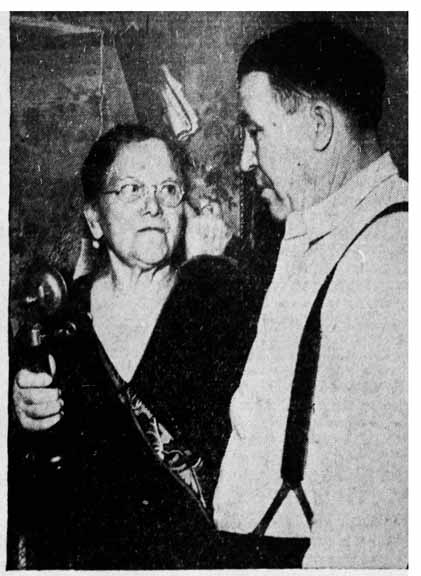
Minneapolis Tribune, November 5, 1935
HAPP’S NITE CLUB
Ads started showing up for dances here in the Minneapolis Spokesman in July 1936. The Spokesman was and is a weekly newspaper for the City’s black community. The first found was for July 26, 1936, advertised as a Cabaret Dance sponsored by the Twentieth Century Club. The venue was described as Happ’s Nite Club, and the entertainment was Ray Dysart’s Swing Band, with a Floor Show. The Sunday night dance started at 10 pm.
The ad below doesn’t mention the name of the venue (or perhaps I cut it off), but it gives great directions on how to get there. I never did find an address.
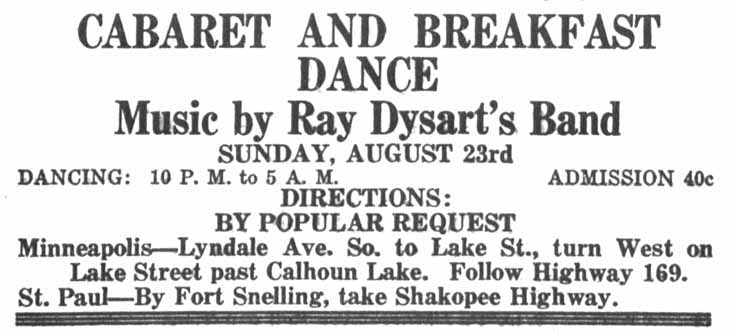
Minneapolis Spokesman, 1936
This was the first ad that gave the city’s name as Shakopee instead of Chaska.
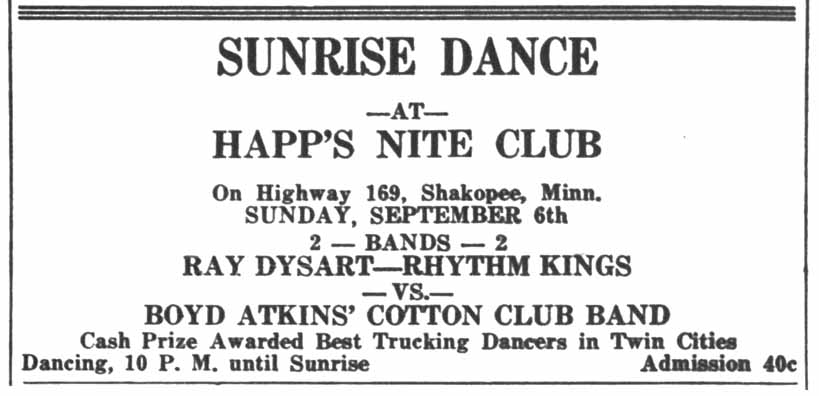
Minneapolis Spokesman, 1936
On November 8, 1936, the Spokesman advertised an Iowa-Minnesota Homecoming Party at Happ’s Nite Club, with music by Ray Dysart and His Swinging Gents. The Party started at 10 pm on a Sunday night and featured favors and a floor show. The address given was Highway 169 in Shakopee.
On Sunday, October 3, 1937, a Breakfast Dance was planned, featuring Red Perkins and His Original Dixie Ramblers, Direct from Omaha. It was called the biggest dance and musical treat of the season, a jam-fest, that included all the local bands, including the popular Ray Dysart and His Swinging Gents. This time the venue was back to being called Happ’s Auditorium, in Shakopee. Dancing was from 11 pm to 5 am. (Minneapolis Spokesman, October 1, 1937)
DOWNFALL OF HAPP’S
On October 18, 1939, this ad was placed in the Minneapolis Tribune:
FOR SALE or lease, Happ auditorium in Chaska, 66 x 112, fully equipped, ideal for many uses, also full basement. Call or write Adam & (sic) Happ, Chaska, or contact Breezy Point Club, mile n of Shakopee.
In 1940, whether as a matter of principle or in a feud with the neighboring Valley Auditorium in Chaska, Happ signed a complaint that the Valley was keeping gambling devices on its premises. Five slot machines were found in a raid at the Valley on September 24, 1940. (Minneapolis Star, October 6, 1940)
FIRE
On Thursday, September 26, 1940, an explosion that shook buildings more than a block away destroyed the Happ Auditorium, described as at the edge of the Chaska business district. The subsequent fire razed the building, and it took Chaska and Carver firemen more than three hours to bring the flames under control. Damage was estimated at $17,000. The explosion was believed to have occurred on the ground floor where four new bowling alleys were to open on Friday. It happened at 5:20 am, just as Chief of Police Joseph Ohnsorg was driving past the two-story building.
Doors flew off their hinges and windows were shattered. Startled townspeople swarmed to the scene. The building was still owned by Adam Happ. The story was on the front page of the Minneapolis Star Journal, September 26, 1940.
The charred ruins of the Auditorium sat in situ for eight years until plans were made for a bowling alley.
628 Selby Ave. was a series of Taverns and cafes serving the neighborhood.
GALLIVAN’S BAR
In September 1943, Proprietor Robert Benning was robbed of about 1,000. In 1952, Proprietor Richard Skok was faced with the revocation of his license for selling strong beer on his light beer license.
Happy Harry’s Tavern was located at Happy Harry’s 628 Selby June 28 1967 Roy Landwehr was beaten to death there in a bar fight. May 1968 James Robinson was stabbed to death there in another bar fight.Ave. in St. Pausl.
KICKED TO DEATH
On June 28, 1967, Roy Landwehr, 42, was beaten to death inside and outside the bar. Witnesses said that Landwehr, a construction worker, had “asked for it” by insulting his attackers. He died of a skull fracture after being kicked to death by four men ranging from ages 17 to 31. Howard Graham, the 31-year-old, was found not guilty by a jury after they found it unclear which one of them had kicked him in the head, leaving his fatal injuries. Based on the verdict, the charges of the other three were dropped. Landwehr left behind five children.
STABBED TO DEATH
On May 18, 1968, James Robinson, from Waterloo, Iowa, was stabbed to death there in a bar fight with Charles L. Spann, 26. Spann fled to Texas, then returned and agreed to a reduced charge of second-degree manslaughter.
This legendary roadhouse, located at 1691 Rice Street at Wheelock Parkway, was just beyond the St. Paul city limits. It had at least three interesting iterations. The last two in the list below were either in the building or nearby.
HAPPY HOLLOW
The Happy Hollow Cafe was a jazz joint, with musicians like Lester Young, Percy Hughes, and Rook Ganz performing there. Although there is some doubt that Kid Cann had a presence outside of Minneapolis, others city Happy Hollow as one of his hangouts. In the 1930s it was owned by the Netto Sisters, and Marjorie Netto was said to be a “paramour” of Kid Cann. In November 1945 Proprietor Robert Wesley was arrested for selling liquor without a license. He pleaded guilty to two charges and was fined $100 and court costs. He was also fined $50 for selling cigarettes without a license. At the time of the raid (2 am) there were 35 patrons in the place.
THE ROCHESTER
This may not have lasted very long, but was called this in September 1946.
TREASURE INN
Lost Twin Cities II has a segment on the Treasure Inn jazz club. It opened on November 2, 1946, and existed for two and a half years. It was owned by three African-American entrepreneurs: Richard Mann, Claude Mason, and Howard Brown. A matchbook advertised its “Hot Sepia Dance Music.” It featured black musicians such as Lester Young, Oscar Pettiford, Percy Hughes, and Prince Rogers, and drew white college kids as well blacks.
A great ad reads “Whamp! Dig this Nervous Opening! Percy Hughes and his great dance band. Let’s Rock! Rock! Rock! Let’s Dance! Dance! Dance! Let’s Go! Go! Go! Real Cool and Crazy!” The dancing got so cool and crazy that the “nervous” owners had to shore up the floor to keep it from falling into the basement.
Leigh Kamman broadcast live shows from the Treasure Inn on his “We Call it Jazz” show, Sundays at 9pm on WLOL.
A contributor to its demise was a fatal shooting on February 13, 1949. Two men were arguing over a $2 debt when one pulled a gun. A third man tried to get the gun away, and ended up with five bullets. During his trial, Inman Nealie pleaded guilty to manslaughter and was sentenced to seven years in the St. Cloud Reformatory. This was the last listing for the Treasure Inn.
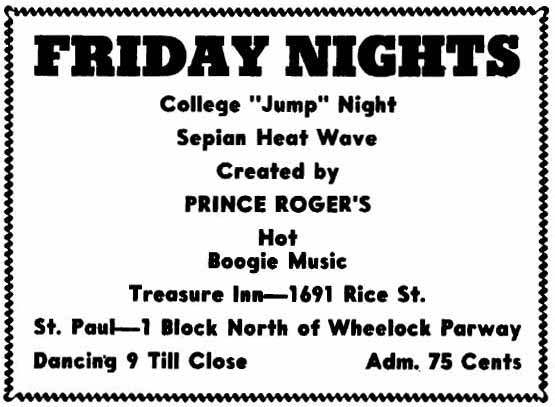
Minnesota Daily. Ad courtesy Robb Henry
There were other St. Paul clubs that were described to be in the same general vicinity:
FLYING DUTCHMAN
The Flying Dutchman was described in November 1935 as being “Out Rice Street Near Wheelock Parkway, One Block Outside City Limits.”
PEARL INN
In November 1935 there was an ad for a dance at the Pearl Inn, “One block off Wheelock Parkway.”
Note that Swing City was across the street at 1682 Rice Street.
For the bar next to the Gay ’90s on Hennepin Ave., see the Gay ’90s.
For the Happy Hour Cafe, located at 1523 Nicollet Ave., see the Flame Cafe.
Cedar Ave., Seven Corners, West Bank. House band in the ’60s was the Houle Brothers, a country and rockabilly band made up of Bobby, Mike, Jim, and Cal Houle, of Cree and French descent. The bar catered to Chippewa Indians, according to Erik Storlie.
The Harlem Breakfast Club was a “Black and Tan” jazz club or “resort” in the terminology of the newspapers of the day. It had two locations, both on Highland Ave. on the North Side of Minneapolis.
Thanks to the map below, we know that 141 Highland was just across the street from the Elk’s Club, which was at 148 Highland. The Breakfast Club’s other location was at 128 Highland, on the other side of the street and down a few houses.
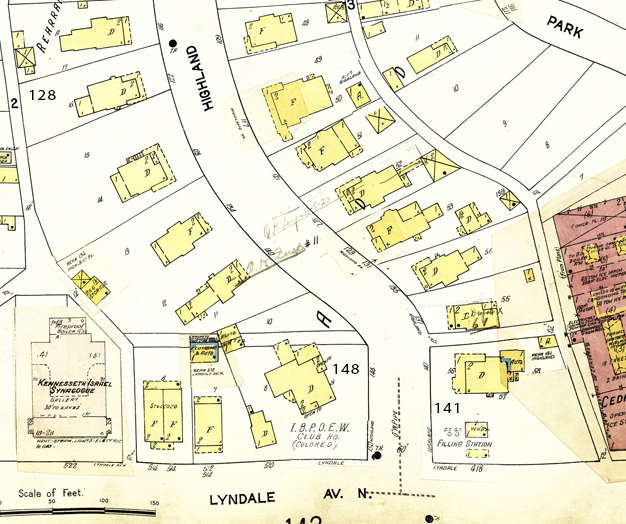
Map courtesy Hennepin County Library
Although there is a photo of the Elk’s Club, there are, unfortunately, no known photos of 141 or 128 Highland. It’s a bet, however, that they were old homes in the Oak Lake Park subdivision. Never heard of Highland Ave? Here’s an explanation, paraphrased from Kirsten Delegard’s report:
Oak Lake Park was an upscale Victorian neighborhood that had its glory years when Minneapolis was in its infancy. Today there is no trace of its curving streets and gingerbread-ornamented wooden homes. The once-wealthy subdivision was bulldozed to make way for a new farmer’s market on the edge of downtown.
Our community’s history of urban redevelopment actualy started, in earnest, with Oak Lake Park. When it was first developed in the 1870s, this neighborhood was home to some of the city’s most affluent residents. These were not the grand mansions of Park Avenue, but rather than homes of successful professionals, like Dr. Augustus Harrison Salisbury, whose grandson Harrison Salisbury would grow up to become a world-famous foreign correspondent.
Residents of the leafy subdivision established the city’s first neighborhood association, which built a small bandstand next to the tiny Oak Lake. And they created the city’s second park, after Murphy Square. But the idyllic neighborhood was quickly overwhelmed by the growing city. Bordered by a growing network of railroads and an increasingly filthy Bassett Creek, Oak Lake Park rapidly fell from grace. People with means were pulled east by Loring Park. By the first decade of the twentieth century, the neighborhood on the edge of downtown had become, in the words of Harrison Salisbury, “the most alien corner of that most Middle Western city of Minneapolis.”
By the 1930s, the city had condemned Oak Lake Park as a slum. This neighborhood was the first target of a three-decade long urban renewal campaign in Minneapolis that would obliterate much of the city’s historic streetscape. Think about Oak Lake next time you visit the downtown Farmer’s Market. It lies buried under the concrete expanse, invisible to modern view.
141 HIGHLAND AVE.
141 Highland had a history of illegal alcohol, apparently – in 1923, a still that was located in the attic exploded with such velocity that it nearly wrecked the house, causing $1,200 in damage.
THE BREAKFAST CLUB
1932
The first restaurant license was applied for in June 1932. This may have been the Musicians’ Rest. Or not.
1933
In May 1933, Philip Ware received a liquor license very soon after the end of Prohibition. It’s fair to assume that this was the beginning of the Harlem Breakfast Club.
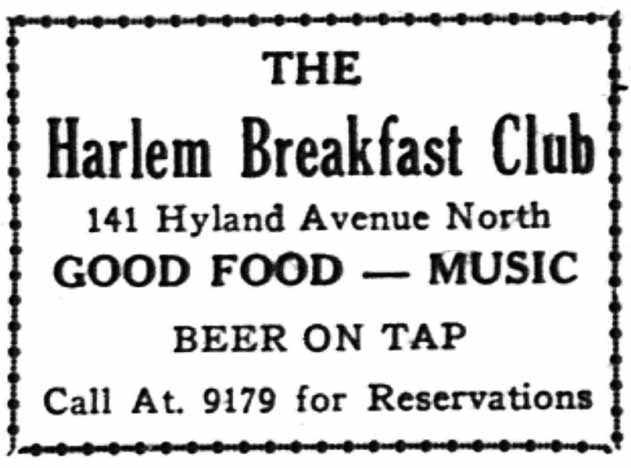
Saturday Press, March 1934
1934
An interesting item from the September 14, 1934, issue of the Minneapolis Spokesman:
The wee hours of the morning at the Harlem Breakfast Club now bring forth a number of University of Minnesota campus big-shots. I noticed two girls who are members of Kappa Kappa Gamma, the snootiest of the campus sororities, a young man well-known in collegiate social circles, and another biggy-wig, – all of them apparently enjoying themselves immensely the other yawning about four. If you know Who’s Who around Minneapolis, you will be surprised at the number of them who frequent sepia night spots …
1936
IT’S A RAID! NO. 1
Ware was arrested with three others in a raid on February 25, 1936, when officials found a gallon of moonshine whiskey. But it was found that since repeal of Prohibition, State law made it impossible for the county attorney to start abatement proceedings against the club upon liquor convictions along, so all charges were dismissed on March 13, 1936, based on insufficient evidence. (Minneapolis Tribune, March 15, 1936)
The last mention of the Harlem Breakfast Club at 141 Highland was also on March 15, 1936 – the Mayor said there was no point in pulling the license since the ramshackle house was slated for demolition to make way for the Municipal Market.
128 HIGHLAND AVE
By July 1936, the Harlem Breakfast Club was up and running again, this time in a building that was across the street and about three doors down. It was built before 1884, the home of lawyer Stanley R. Kitchell. But by 1911 it was a duplex, and in 1934 it was a 13-room rooming house.
Despite the raid earlier in the year, Philip Ware was again running the Harlem Breakfast Club, now here at 128 Highland.
MAPLE LEAF CLUB
Philip Ware was back, managing this new club at 128 Highland. The Spokesman began either running very small ads or including it in a list of businesses to use, on August 13, 1937. What’s odd is that while the Spokesman refers to it as the Maple Leaf Club/Musicians’ Rest consistently through November 17, 1939, the Star and Tribune just as consistently called it the Harlem Breakfast Club during the same time.
IT’S A RAID! NO. 2
1940
The Maple Leaf Club/Harlem Breakfast Club was back in trouble again. On August 11, 1940, Detective Sig Couch, described as the Police Department’s one-man morals squad, conducted a raid on the Harlem Breakfast Club. The Minneapolis Tribune‘s fanciful report of this event will bear repeating in this account.
Detective Couch has figured it out: If you can keep the customers away from the the joints, there won’t be any joints.
The raid began at 3:45 am. Undercover men, each with a girlfriend, were seated in each of the four rooms used for service on the first floor. The officers used small hot water bottles to capture samples of liquor served after hours.
When the raid began, hilarity was at an early-morning height. Glasses were on the table. The orchestra were playing. Laughter ran from group to group.
“One-man” Couch ran true to type by going in first, alone. His good-natured countenance quenched nobody’s fun, with one exception. Detective Couch said Everything went on as before, except that when Philip Ware, Negro, recognized him, Ware’s face fell as if it had been dropped from a great height.
Ware started for a back room. When Couch caught up with him, Couch said, Ware had a finger on the button of a buzzer. Couch and some of his helpers traced the buzzer wires to an upstairs room. There seven Negro men were sitting in pointedly innocent attitudes at a round table. Two other men were standing, fixedly watching them do it. Nobody was saying a word.
… Couch was impressed by the numbers of persons who had just dropped in for a coke. They told him about it – hopefully.
Meanwhile the detectives were finding four pints of bourbon and tw quarts of gin in an automobile parked outside. Couch had another theory. It was that the automobile belonged to Ware.
Found inside the building were cigarets which Couch has an idea are made of marihuana. They were in a case, he said, which contained the name of one of the employes.
He arrested everybody, the asserted proprietor, the orchestra, the waters – and the customers. In all 41 went to city jail. 18 of them Negro men and nine of them white women with white escorts. Two patrols wagons made two trips.
Down at the jail, 40 were booked on charges of being found in a disorderly house. Ware was charged with being the keeper. Everybody, including Couch, was crestfallen to discover that the statutory bail for the 41 was $200 each. But obligingly, Couch and the jailors, with the sanction of a judge, soon fixed it so that only Ware had to put up $200. Last night all the rest were free on $25 bail each.
This may be an important paragraph:
The one-man morals squad said the Harlem Breakfast Club had first upset him when he quietly scrutinized it a week ago. He said he noticed that although white men were refused admittance unless accompanied by girls, stag Negroes got in. He though that was discriminatory and decided to do something about it.
Coverage by the Minneapolis Spokesman pointed out that all the white people arrested, male and female, were customers, while all the black people in the place were all black men and were all either employees or musicians. It was also argued that the press played up one officer’s account that there was a mixed couple dancing together, but there was no law against this activity, prejudice was behind the raid. (August 16, 1940)
The trial was quick – everyone was tried together. There was much discussion of the definitions of the terms “tippling house” and “disorderly house,” and many different accounts of why people were there and what they were doing. On Monday, August 19, 1940, Ware was sentenced to 90 days in the Workhouse for being keeper of a disorderly house. He was give a stay to September 9 to appeal, and continued his $200 bail. On September 25, 1940, his motion for a new trial was denied and he was ordered to serve his 90 day sentence.
The other 40 defendants were fined $5 each for being found in a disorderly house. His decision was partly based on the fact that people had been dancing despite the fact that Ware had no dance hall license, and that liquor was found in the kitchen and in Ware’s car, parked nearby.
On August 30, 1940, Ware was denied permits for food, cigarettes, and soft drinks, basically putting him out of business.
And there’s this, found by my friend Melinda Russell:
Lookie, Harlem Operators, Minneapolis Cops are Mean
Seventeen Negroes, 14 white men and nine white women were in the net of the raid by the police department here Tuesday which was launched as a drive against all-night, non-licensed liquor selling clubs. The raid was staged on the Harlem Breakfast Club, a black and tan layout. All the prisoners got fines of $5 each. (Amsterdam News, September 7, 1940)
1941
CLUB DE LUXE
It says here (perhaps in ads in the Minneapolis Spokesman) that the Club De Luxe opened in January 1941.
IT’S A RAID! NO. 3
But it was the Harlem Breakfast Club that was raided on September 12, 1941. The Minneapolis Star Journal published a big front page headline:
4 Nabbed in Harlem Breakfast Club Raid Given 90-Day Terms
The raid started at 2:20 am, led by morals squad leader Elmer Hart. Hart was denied admittance and had to break the glass on the front door to get in. There were 25 to 30 black and white patrons in the club at the time of the raid.
Three men pleaded guilty to selling liquor without a license, and one pleaded not guilty and was found guilty. It’s a little unclear whether the raid and the trial were on the same day?
1942
RAID 3 AND YOU’RE OUT
On April 6, 1942, the City Council’s health and hospitals committee denied an application for a license at the Highland Breakfast Club, 128 Highland Ave. Either this is a typo and should be Harlem Breakfast Club, or someone is trying to carry on with a slightly different name. Whatever the circumstances, it’s over.
AFTER BREAKFAST
128 Highland had a busy life after the Harlem Breakfast Club.
1943
NEW PALMS CAFE
On January 15, 1943, the Minneapolis Spokesman published an ad that the New Palms Cafe was Now Open at 128 Hyland, promising good food, music, and entertainment. The ads ran through February 12, 1943.
THE RHUMBOOGIE CLUB
The Rhumboogie Club opened on June 15, 1943 – “You’ll Enjoy Yourself.” The name apparently originated in a song that the Andrews Sisters performed in their screen debut in “Argentine Nights” (1940). The Rhumboogie Club in Chicago was located at 343 East 55th Street, opening in April 1942 and partly owned by boxing champion Joe Louis. There was also a Rhum Boogie Club in Harlem in 1943. Unless there was something in between, the Minneapolis Rhumboogie lasted from June 1943 to 1945.
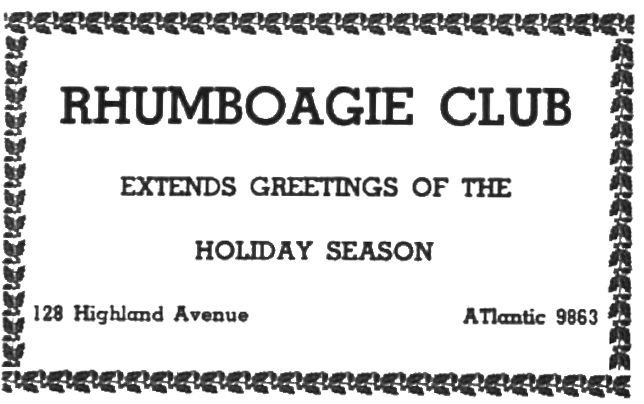
Minneapolis Spokesman, December 24, 1943, via James Orndorf. Never mind the spelling.
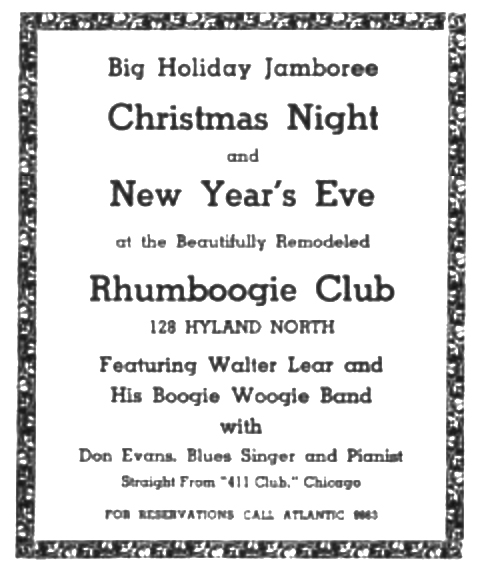
Minneapolis Spokesman, December 24, 1943

Minneapolis Spokesman, via James Orndorf
1945
The Cara Okara Cafe opened on November 29, 1945. Reese L. Martin was the proprietor. The ad below ran on November 30 and December 7, 1945.
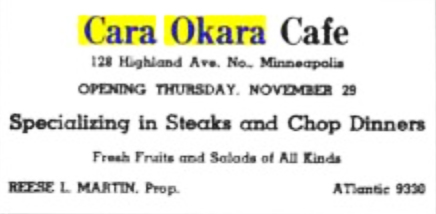
Minneapolis Spokesman
1947
SAM’S BAR-B-Q
Samuel D. Gransberry was the proprietor of Sam’s Bar-B-Q, and on Sunday, May 4, 1947, Sam was arrested and charged with selling liquor without a license. Also arrested were 15 customers of Sam’s, charged with violating liquor laws. Sam was released on $200 bail. He was eventually given six months probation.
Then on September 8, 1947, Robert Glenn was sentenced to 90 days in the workhouse for selling liquor without a license. The name of the place was not given, but 128 Highland was described as a night club and barbacue place. (sic) In 1948 a Robert Glenn was working for A.B. Cassius.
The building was listed as a cafe for sale in September 1947.
VFW
The Johnny Baker Post 291 of the American Legion used the building from at least July 1948 to October 2, 1953.
1953
In May 1953 it was advertised for sale as a vacant rooming house.
1957
The building was demolished in 1957.
1311 Washington Ave. So. In November 1939, Jessie Scott, Entertainer-DeLuxe Appeared Nightly.
According to an early history of Minneapolis theaters, Harmonia Hall was our second theater, “and the one that better suited the ideas of the Minneapolis theater-going public” than Woodman’s Hall. (Minneapolis Tribune, January 1, 1882)
HARMONIA HALL I
The first Harmonia Hall was built in 1859 at Second Avenue North and Second Street. It was built by the Harmonia Singing Society, an organization founded in the early 1860s by members of Minneapolis’ German community.
“Harmonia Hall boasted a proscenium, a decided advance among these temples of Thespis, and this proscenium is still standing – a bizarre anachronism in a remodeled building now used for the storage of hides. Generations of strolling players, forgotten plays, the genesis of the present symphony orchestra, amateur players forgetting their lines, the Swiss Bell Ringers, Fay Templeton, stereopticon lectures, ‘Buffalo Gals’ sung in a blackface act – the proscenium with diamond-shaped panels set at decorative intervals has seen them all.” (Edgar)
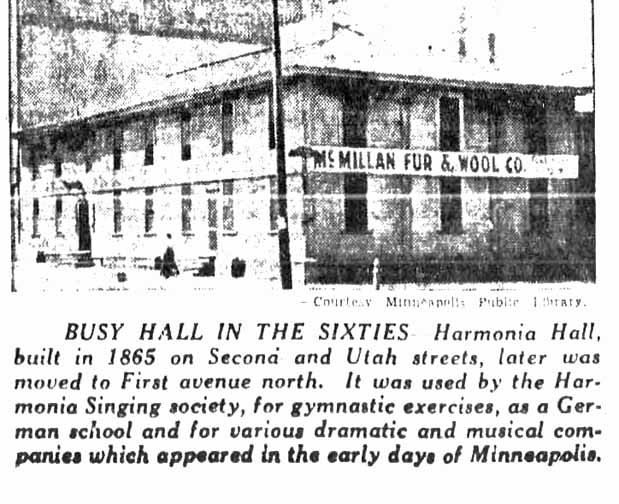
Minneapolis Tribune, January 27, 1935
In 1868 the building was redecorated with life size paintings and ornamental scroll work on the ceiling.
The building served several purposes:
- It was used by the Harmonia Singing Society
- Gymnastic exercises
- A German school house
- Various dramatic and musical companies who appeared from time to time. (Minneapolis Tribune, January 27, 1935)
Edgar wrote:
Rival theaters crowded into the neighborhood of the Harmonia and these in turn disappeared. Finally the Harmonia was closed and its name transferred to a new place of amusement. The seats were removed, the stage pulled down, and all things that had borne the semblance of a theater, with the exception of the proscenium, ceased to exist.
By 1882 the building was a place for storing and bargaining in hides and pelts.
Before 1935 the building was moved to 200 First Avenue North.
HARMONIA HALL II
In 1884, the Harmonia Society, now over 200 members strong, built a new Harmonia Hall. The City’s official address is for this building was 200-218 Third Street South (at the northeast corner of Second Avenue South and Third Street – Minneapolis Music Report).
The permit card shows the original footprint to be 88 x 120 x 66 (4 stories), to be built at a cost of $500,000. The wrecking permit shows two buildings: one with the dimensions above, wrecked in December 1961, and another with the dimensions of 66 x 120 x 38 (3 stories), wrecked in October 1962.
Its Norwegian-born architect, Carl Struck, was the same architect who designed Dania Hall. Activities were to include concerts, operas, plays, and other events.
Architecture critic and author Larry Millett describes the building:
The building had reddish brick walls threaded with bands of white Ohio sandstone. There were long rows of pointed-arch windows on the upper floors. The mansarded attic was full of dormers and pinnacles. An angled corner tower rose above bay windows.
The horseshoe-shaped auditorium took up the second and third floors. The stage was on the Second Ave. side, while the amphitheater extended eastward. The original auditorium seated about 1,000 people. Later, the balcony would be made into a third floor.
GRAND OPENING
The Grand Opening was held on December 13, 1884. The proceedings featured a concert by the Frank Danz Orchestra and other musical numbers. There was “a neat little play,” and a speech (in German) about the early days of the Harmonia Society. After a feast there was music and dancing. (Minneapolis Tribune, December 14, 1884)
German, Scandinavian, Irish, and other organizations used the hall for a variety of events.
Permit cards show other early activities in the building:
- A bowling alley
- Saloon (as early as 1893)
- Printing shop
- Factory
- Pool Room
- Private Garage
This was a huge building, so there were a lot of addresses associated with it, some on Third Street and some on Second Ave.
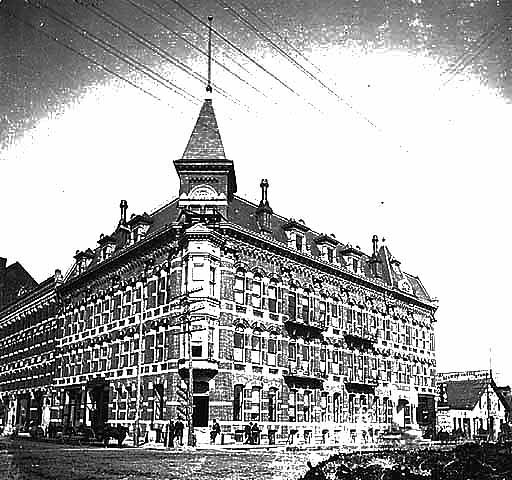
1885 photo courtesy Minnesota Historical Society
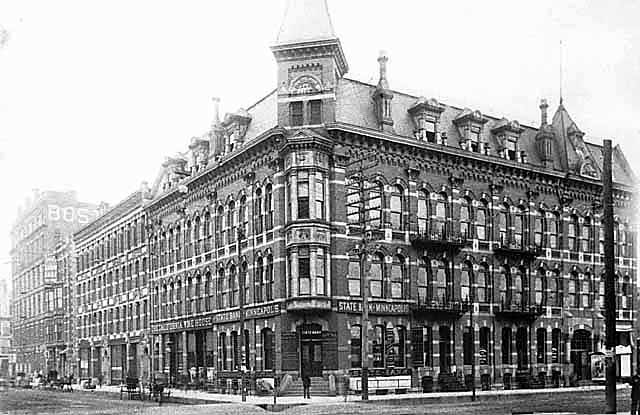
1890 photo courtesy Minnesota Historical Society
DEPRESSION
The Crash of 1893 affected about everyone, and the Harmonia Society was no exception. They were forced to default on the hall’s mortgage, although the hall itself stayed open.
In 1899 it was announced that the hall would be transformed into the New Harmonia Theater, a beautiful amusement auditorium. It would host vaudeville acts and have a house orchestra that was familiar with the “catchy music” of the day. (Minneapolis Tribune, April 30, 1899) The last notice for the theater in the paper was in January 1900, however, and it appears that the building reverted to the name Harmonia Hall.
The first indication that the building was being converted to a hotel from the permit cards was in July 1903. A note in the Minneapolis Journal said that J. Schutt and Sons were making $13,000 in improvements in the building and were contemplating more. (June 13, 1903) Unfortunately, a plasterer was killed that July during that renovation. The stage was torn out and the balcony was turned into a third floor. The building became commercial property and quickly filled up “from cellar to garret.” (
Boxing took place at the Hall in 1903 – apparently without the proper permission. Other uses were “low class dances” and wrestling matches.
On January 28, 1905, fire destroyed the upper floors of the hall, including the auditorium and the attic. Six people, including a couple with a baby, managed to escape, with the baby being dropped 23 feet from a fire escape into the arms of a waiting fire fighter. The permit card estimated the cost to repair at $7,500. News reports say that the building was owned by the John Noble Estate and that the building, described as dilapidated, was insured. Damage was estimated at $150,000. Ten businesses were affected, including William Dunn’s Saloon. This story was told in magnificently flowery language in the Minneapolis Tribune, January 29, 1905.
THE COLLEGE BLOCK
The building was rebuilt after the fire, but without its attic and tower. Architect Glenn L. Saxton designed the third floor for the Caton Business College, and on January 1, 1906, the building became known as the College Block. A new front entrance was constructed on the Second Ave. side, and ads show that the college’s address was 253 Second Ave. So. But they also show that the name didn’t make it out of 1906.
REX HOTEL
The first ads for the Rex Hotel are from May 1907. The Rex was in Skid Row, and for men only. On August 29, 1907:
Traveling men are invited to inspect the new Rex Hotel. Superbly furnished. Newest in the City. (Minneapolis Tribune)
Ads offered private dining rooms on the second floor, serving the choices delicacies of the season, catering to after-theater parties. It wasn’t long before a waiter was caught serving liquor to someone in one of those private dining rooms, way after closing time. $35 fine.
This is confusing. There were two buildings. In 1909 there is an article about building or renovating the Rex to provide a place for transients. This is the Rex for men only that we think of on Skid Row.
Please See Lyceum Theater
According to a history of local theaters written in 1892, Harrison’s Hall was the third theater in Minneapolis, erected in 1864 at Washington and Nicollet. The article called it “a Thespian temple of great pretensions.” The theater was located on the third floor of the building. (Minneapolis Tribune, January 1, 1892)
Edgar considered Harrison’s Hall our first entertainment hall, as it was the first place of amusement with full stage equipment. Other gathering places had been been built with slightly elevated platforms at one end of the room.
The theater was short-lived, and the building was turned into offices. “Dramatic rights” were surrendered to the newly-erected Pence Opera House and Second Street and Hennepin Avenue in 1867.
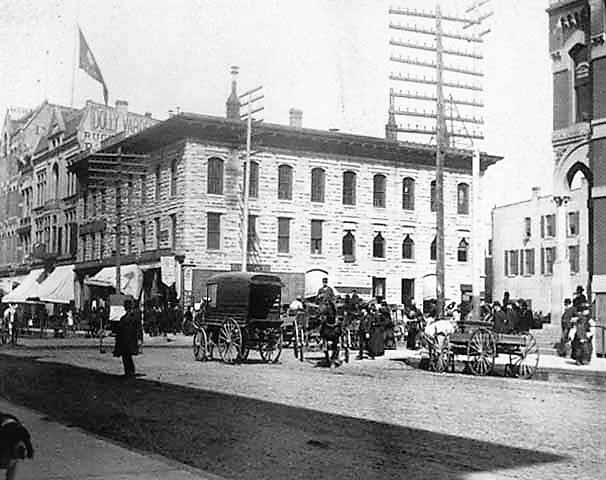
22 South Washington, 1886 – Minnesota Historical Historical Society
The building was demolished in 1957 (Minneapolis Music Report).
74 S. 11th Street, Minneapolis. In 1939 it was described in the Spokesman as “swank.” It burned down sometime in the 1970s – it was in the winter and folks remember it encased in ice.
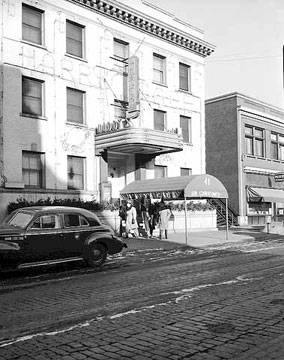
Photo from 1948 – Minnesota Historical Society.
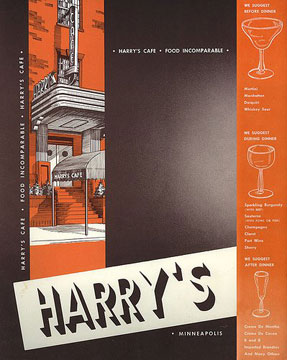
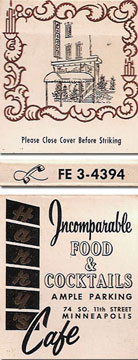
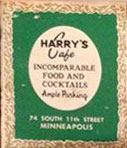
Green matchbook from the collection of Scott Bottolene as posted on Facebook.
Please see Duffy’s.
Please see Alary’s.
Please see Lyceum Theater
324 MARQUETTE
The three story building at 324 Marquette was a rooming house with a saloon on the first floor in the ‘teens before Prohibition. Notable in the wantads in 1914 and 1915 were the words “White only” and “No Negroes may apply.”
During Prohibition, it appeared that the City of Minneapolis didn’t quite know what to do about drinking and gambling, and evidently gave up on trying to control the gambling in the City. 324 Marquette became McCurran’s, with characters like “Kid” Taylor and “Jake” Stearns running roulette, faro, blackjack, and poker concessions. (April 10, 1922). But then raids resumed, and by the end the building was probably empty because it was hosting church rummage sales.
But then Prohibition came to an end, and it became something called the Met. Cafe, abbreviated because it was only advertised in the wantads. In January 1934 it was up for sale and we learn that it seated 52 people.
PERSIAN BAR
The place was the Persian Bar from April 7, 1934, to 1946. From the ad below, it appears that the Persian Bar was an offshoot of the Persian Club (not the Persian Cat Club, which was another thing entirely), located at 1554 Nicollet Ave. between 1932 and 1934. Like most Prohibition-era establishments, the “Club” got in plenty of hot water before it moved, got itself a license, and did whatever it did down there in the Gateway.
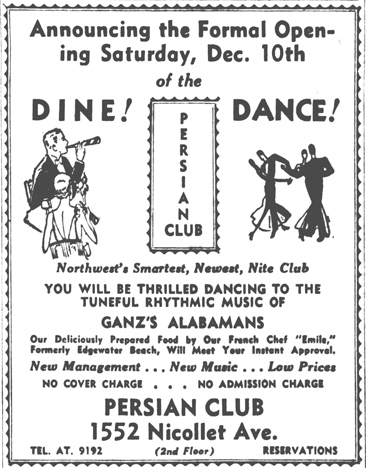
This is the Persian CLUB – ad dated December 10, 1932. Prohibition still in effect.
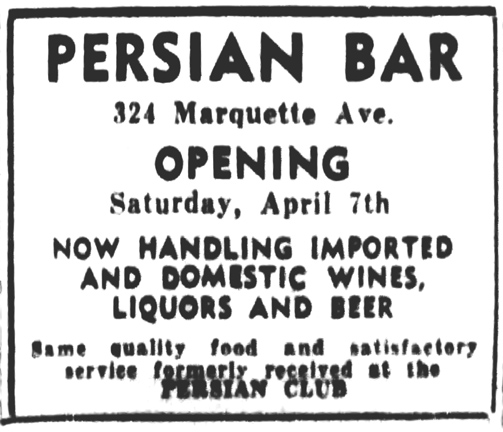
This is the Persian BAR, ad dated April 7, 1934.
One of the partners at the Persian Bar was Mitch Code, a local mobster who was fortunate to die in 1946 before he received retribution for gambling and drinking away $41,000 while his fellow mobster Tommy Banks was away. (Minneapolis Tribune, June 19, 1959).
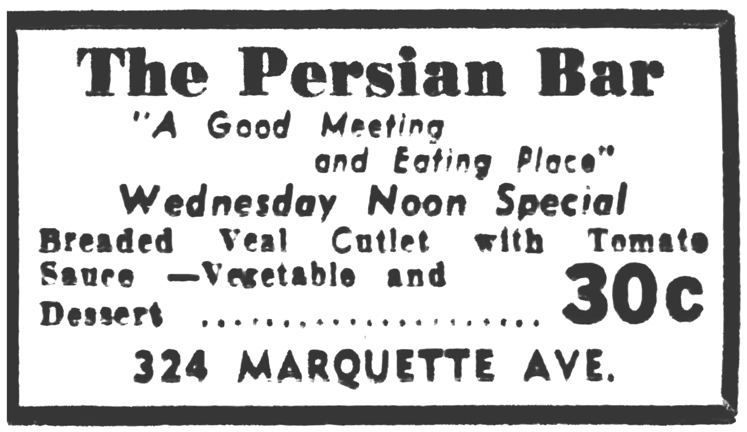
July 13, 1938
HERB’S #1
Herb’s opened at 324 Marquette Ave. in Minneapolis in 1946. It was owned by Herb Klein, a Big Band singer from the east coast and a brother-in-law of Henry Sabes, who owned the Key Club (Minneapolis Tribune, May 8, 1961). The first thing found in the Minneapolis paper is a blurb about a fight at Herb’s in November 1946 that put a man in General Hospital!
Stebbins described it as “Another night club in Minneapolis which became the principal rallying point for modern jazz musicians in the late 1950s.”
Skeets Reiman played Hammond organ and piano here in 1954.
Stebbins noted that “it was almost ten years before anything of significance for jazz was to be found. Herb Pilhofer, a native German who had arrived in Minneapolis around 1954, led a trio here, off and on, from 1955 to 1961, when the place was torn down…”
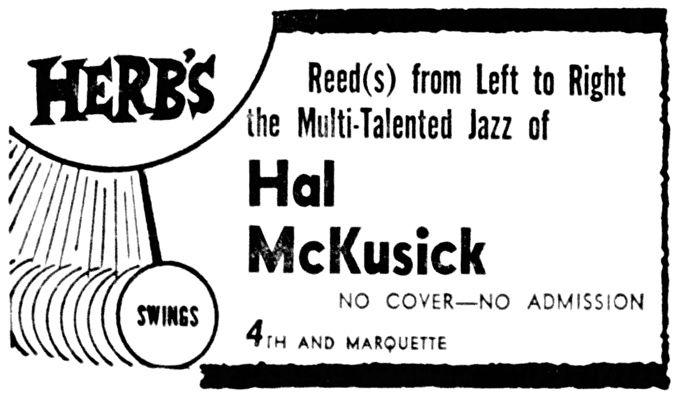
October 23, 1959
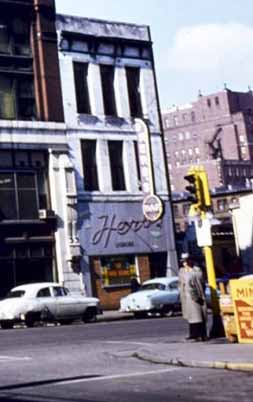
Herb’s at 324 Marquette, 1959. Photo courtesy City of Minneapolis
Herb’s preserved a nice balance of local and out of town talent. Twin Cities jazz musicians crowded around to hear Barney Kessel, the Three Sounds, Red Garland’s Trio, Herbie Mann, and others. Often Pilhofer’s trio served as the house band on these occasions.
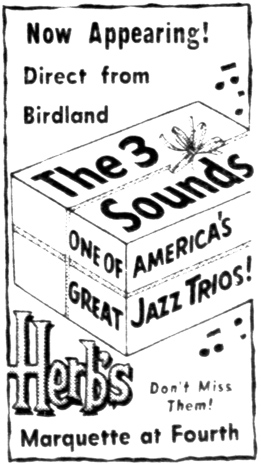
Minneapolis Star, May 14, 1960
The building was torn down for the Gateway Clearance project. The auction was June 5, 1961. The Sheraton Ritz Hotel was built in 1963, but was demolished in 1990 – the site is now a parking lot.
HERB’S #2: 654 SECOND AVE. NO.
After a stint as the “Host” of the Key Club starting in September 1961, Klein opened a second iteration of Herb’s at 654 Second Ave. No. at Glenwood Ave. in late 1963. His application for a liquor license had been been “bounced around” by Aldermen on the City Council for several weeks until a split decision was reached to approve it on July 12, 1963. (Minneapolis Tribune, July 13, 1963)
Will Jones described the new Herb’s as twice as big as the old place and four times as fancy.
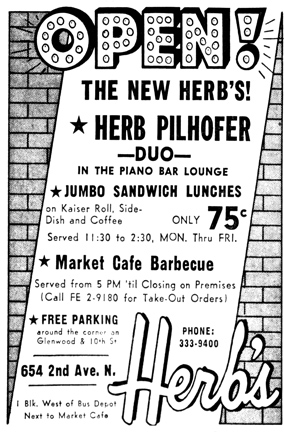
The New Herb’s first ad, November 14, 1963
In November 1963 the entertainment was the Herb Pilhofer Duo, with Ted Hughart on bass.
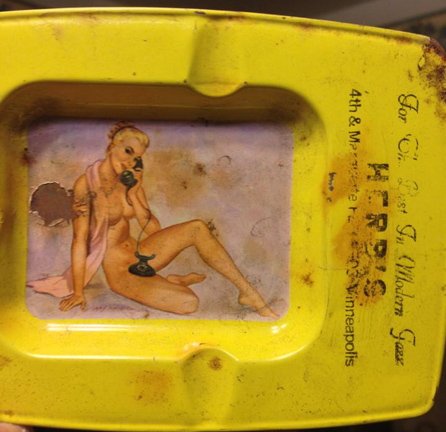
Naughty ashtray courtesy Johnny Kumpula
In 1964 the club featured Jim Marentic’s Quartet, a modern jazz band.
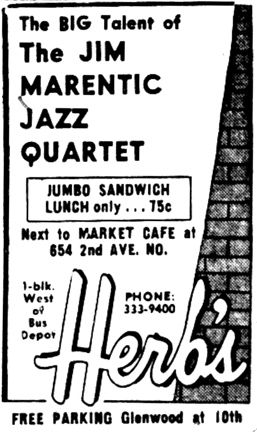
March 18, 1964
On January 11, 1965, a fire caused $50,000 damage to the club. It was thought to be set by burglars who used acetylene torches to burn through the safe.
From January 1967 to the end of July 1969, the house band was the rock band Gary Neilson and the Nite-Caps.
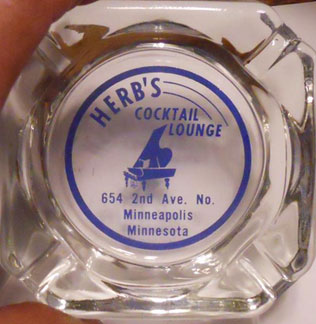
Ashtray from the collection of Mark Youngblood
Herb Klein died in 1988.
SWEET GEORGIA BROWN’S
On August 1, 1969, Herb’s became Sweet Georgia Brown’s.
The Frank Edwards Trio was the house combo until a big name policy was instituted in August 1970.
On December 10, 1970, Will Jones reported that Sweet Georgia Brown’s had been closed for about a month, but had reopened under a new name: Big Dee’s.
JETAWAY LOUNGE
March 1971, Will Jones reported that the place had become the New Jetaway, after a popular Miami club. Dick Campbell was the former manager of the Peacock, and became the manager of Sweet Georgia Brown’s in 1970. At that time he enlarged the club for dancing, but in 1972 he discontinued having live bands on week days, as it didn’t pay. He said that all the clubs downtown were “switching over to tapes.” (Minneapolis Tribune, November 27, 1972)
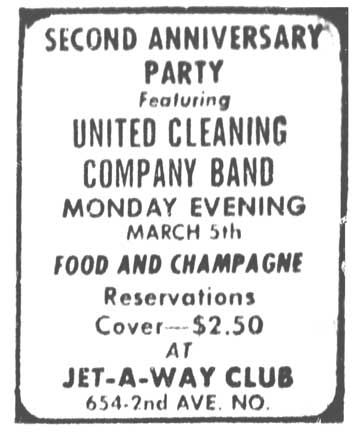
March 3, 1973
GOOFY’S
In 1974 the place became Goofy’s.
Goofy’s was owned by Moe Emard and Joe Houle. Houle also owned Joe Houle’s Peanut Bar on 26th and Nicollet.
In 1974 it was described as
attracting a large young-and-old crowd after dark with a nutty policy of juke-box dancing and pool-table Foosball and pinball action. Especially popular is a back-of-the-room alcove with bean-bag seating that is separated from the dance floor by a curtain of clear plastic dangles.
A kind of “hang-down hang-out” read one news item.
Folks remember the time clock on the wall – whoever put in the most time at Goofy’s got a free pizza on Friday.
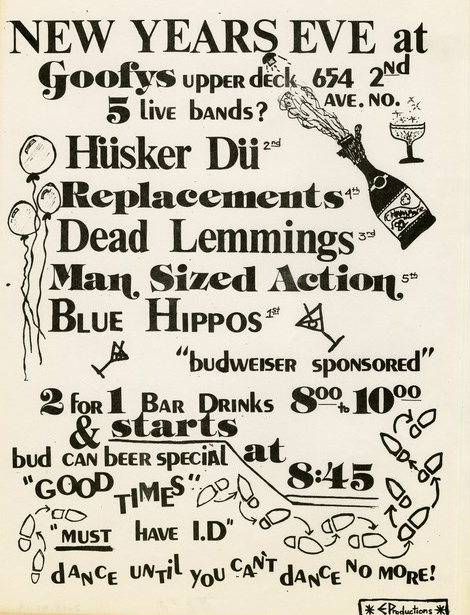
New Year’s Eve Bash, 1981. Handbill courtesy Minnesota Historical Society
The last mention of the address in the Minneapolis paper was January 15, 1988, when Goofy’s advertised for dancers.
Goofy’s was demolished to make way for the Target Center – its last day was February 29, 1988.
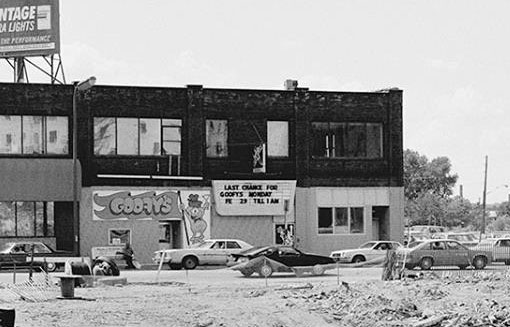
Goofy’s, just before demolition, 1988. Photo by Barb Economon.
The Here was a folk club located at 818 Washington Ave. SE.
THE BUILDING
The history of the building is a bit confusing, as the permit cards specify that it was two buildings in the beginning. One of them must have been demolished at some point.
In 1905 it was the site of Ye Olde Tyme Bakerie, one of five locations.
In 1906 it was John Flygare’s Restaurant.
From 1907 to 1909 (and perhaps longer) it was the Oak Cafe.
In 1928 to 1930, Rose Sabesewitz ran a grocery and meat market.
In 1931, D. Sudit had a license for a grocery store.
In May 1933, Hubert Irsfeld either applied for or obtained an on and off-sale beer permit, just over a month after Prohibition ended.
In July 1933 the cafe was for sale: 12 booths, a 9-chair counter, and a license for draught beer.
From August 29, 1933, to September 11, 1945, Leonard Vrooman ran Leonard’s Cafe.
THE GRIDIRON CAFE
From September 1947 to September 1959 the building was home to the Gridiron Cafe. When it went up for sale it had 11 booths and 13 stools.
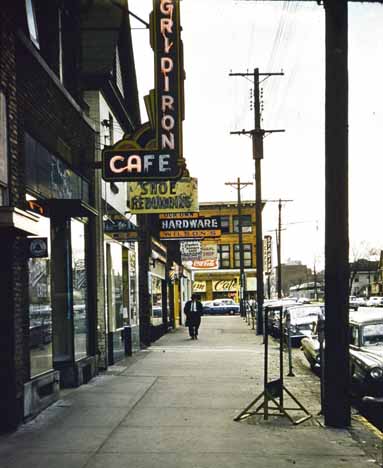
1961 Image courtesy Hennepin County Library
THE HERE
The first notice picked up in the Minneapolis Tribune was for a reading of Dylan Thomas’ “Under Milk Wood” by eight college drama students, August 24 and 25, 1962. At the time, the place was identified as the Here Gallery Cafe. (Minneapolis Tribune, August 17, 1962). We find out later that it was owned by Mel Lasley. (Jon Bream, Minneapolis Star, December 16, 1975)
On December 7, 1962, the Greenwood Singers were scheduled to play.
On January 13, 1963, the Minneapolis Tribune announced that Here was holding a contest for local folk singers, singles or groups, Monday through Thursday nights. The prize was a week’s booking at the coffeehouse.
On April 26, 1963, Brian and Paul were scheduled to perform. (Minneapolis Star)
From the May 22, 1963, column of Will Jones, who quoted “blues singer John Koerner:”
This weekend the owner of the Coffee Break (where I work) and the Here is bringing Big Joe Williams to the Here on Washington Av. just down from Oak St. Williams is one of the few remaining and one of the best Negro country blues singers. Between his sets myself and my two companions in blues singing, Snaker Dave Ray and Tony (Little Sun Glover, will do some of our own work, party to plug our soon-to-be-releasd album on the Audiophile label. The record should be out in a week or two and will be called “Blues, Rags and Hollers.” (Minneapolis Tribune)
Will Jones’ interest in The Here continued; from his column of August 30, 1963:
For any adult who finds himself upset by a visit to Teen Danceland at the State Fair, I’d suggest another stop as an antidote. This would be a Sunday-night visit to The Here, a near-campus coffeehouse on Washington Av. at SE Oak St.
The Sunday night attraction there is a group called Mike, Debbie and Denny. Mike, the leader, diffidently explains that they don’t call themselves folk singers, but singers of American ballads. The voices are young and sweet, the seats comfortable, the coffee good, the atmosphere serious, the crowd and performers agonizingly young. They even look faintly embarrassed by the bold words to “Samuel Hall.” But it is a soothing, doubt-erasing experience that helps to answer some of the questions about the capabilities and future of the generation that may be raised by visits to other hangouts of the young.
REV. GARY DAVIS
On Friday, November 22, 1963 – the day of President John F. Kennedy’s assassination – Don Morrison’s review of a show by the Rev. Gary Davis at The Here appeared in the Minneapolis Star. Most of it had to do with Davis’ performance, and that he would be there through Sunday. He did not write about the venue, unfortunately. He did opine that the “current folk song binge has set many teeth on edge, including mine,” because “the dead hand of the music industry promoter-packager-peddler is all too evident and because most of the self-identified folksingers are too young to remember John L. Lewis, let alone John Henry.” But he described the show as “delightfully ramshackle.” (Minneapolis Star)
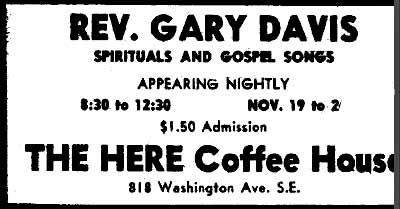
Minnesota Daily, November 22, 1963. Ad courtesy Robb Henry
References to The Here drop off at this point, or are too difficult to search for.
CAMPUS PIZZA
By December 1, 1965 (and perhaps earlier), the space had become Campus Pizza, which it remained until at least June 1992.
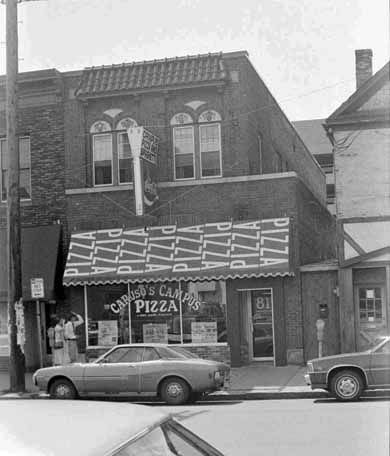
Campus Pizza, 1980. Image courtesy Hennepin County Library
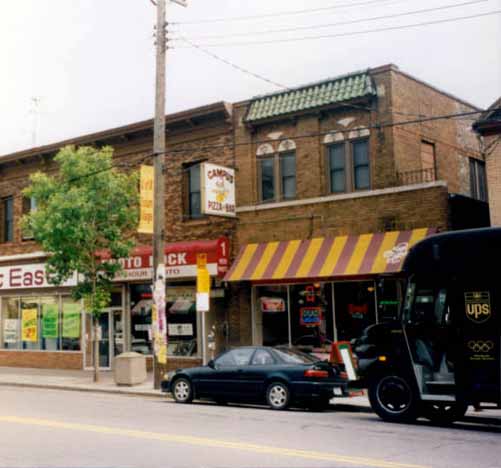
Campus Pizza, 1998. Photo courtesy Hennepin County Library
REDEVELOPMENT
In 2011, the six-story Stadium Village Apartments (now Flats) were built from 810 to 818 Ave. SE.
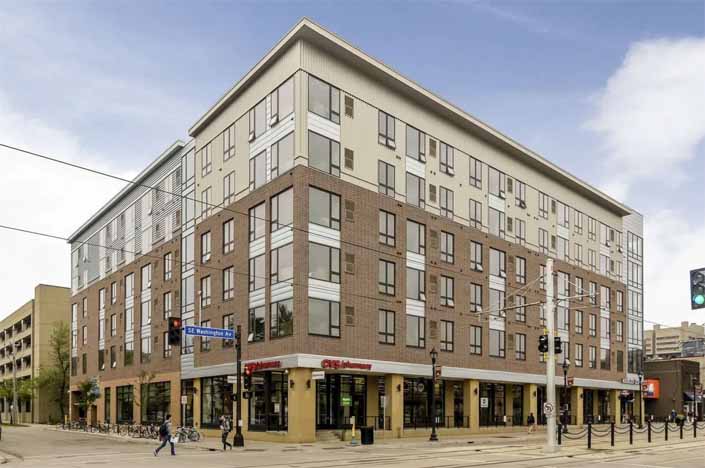
32 South 6th Street, Minneapolis.
1961: Joni (oo, those lyrics!) Barclay in the Artists and Models Room. Frank Oliveri at the Piano Palette.
1963: You could have your picture sketched while you were entertained by Rusty “Oh-Those-Lyrics” Nielsen, apparently a Scandinavian knockoff of Rusty Warren. Or swing with Jimmy Harris at the Piano Palette.
The Hexagon Bar is located in what was know as the “Hub of Hell:” 26th and 26th, Minneapolis. The address is 2600 27th Ave. So.
THE BUILDING
The building was built in 1903 as a saloon, reportedly owned by the Schlitz Brewing Company. Its original size was 22′ by 60′. In 1907 an addition was built of equal size.
During Prohibition it bided its time as an office, barber shop, pool room, store, etc.
THE HEXAGON
The words “saloon,” “tavern,” and “bar” re-appear on the permit card in June of 1934. The Hexagon was named for its six-sided wooden bar that had a center island cooler with cash registers and liquor step-ups above it. That bar was removed during a 1980s remodeling.
In February 1936, John E. Weindel was listed as the owner of the bar.
By 1941 the owner was William Smith Reilly.
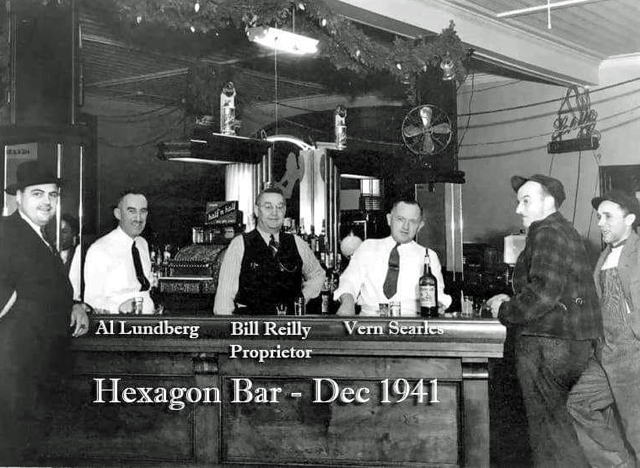
In April 1943, Reilly was fined $300 plus court costs for “evasion of floor tax on liquor.”
In 1946, Bill Reilly transferred ownership of the bar to his sons, Claude J. Hupp and Hupp’s step-brother, John W. Reilly.
In December 1951, in an account of his kidnapping and robbery, the owner was identified as Jack Reilly.
In February 1954, owners, Hupp and Reilly were charged with altering bottles of liquor. The offense was putting a cheaper brand of whisky in a name brand bottle. Apparently the practice was rampant and the police were cracking down. In October Hupp and Reilly transferred their liquor license to their wives. In February 1956 the men were each fined $1,000 and given three years probation.
In the 1950s, the Hexagon was a workingman’s bar where polka music could be heard.
Meanwhile, the bar was pretty regularly being held up, by bad men with heavy artillery.
A 20′ by 45′ addition to the back was built in 1961.
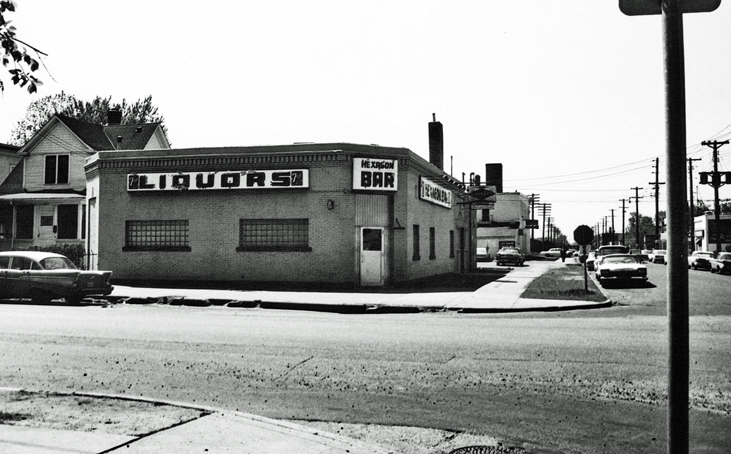
May 1965 photo courtesy Hennepin County Library
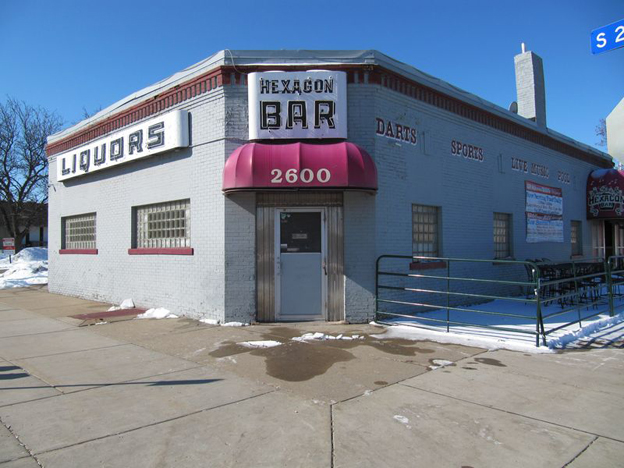
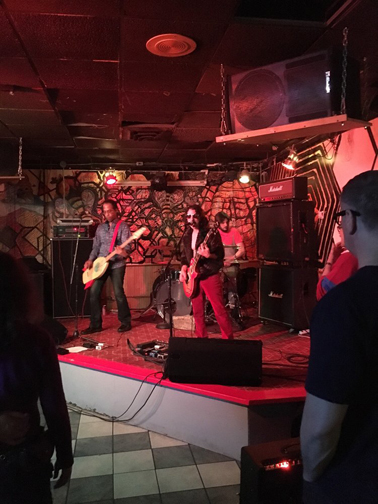
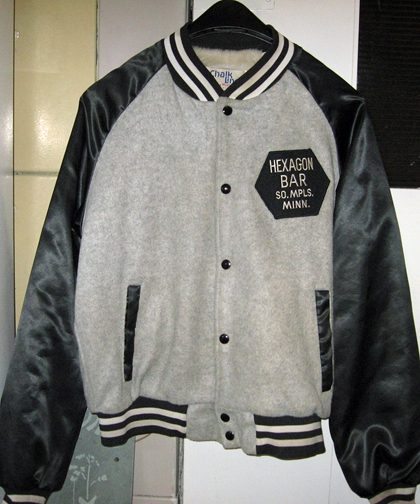
Jerry Schaller’s Hexagon Bar Jacket
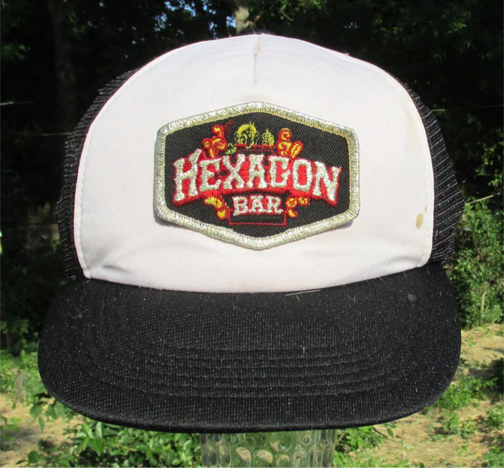
Jeffro Zigmund’s Hexagon Hat
HEXAGON BAR BURNS AS TWIN CITIES ROIL WITH RAGE AND PAIN
George Floyd, an unarmed black man, was killed by white police officer Derek Chauvin on May 25, 2020. In the following days, Minneapolis was a powder keg of outrage that burst into violence. The headline above is how Jay Gabler of the Local Current Blog described the situation on May 29, 2020, as he reported that flames engulfed the 84 year old building between 2:00 and 3:00 am.
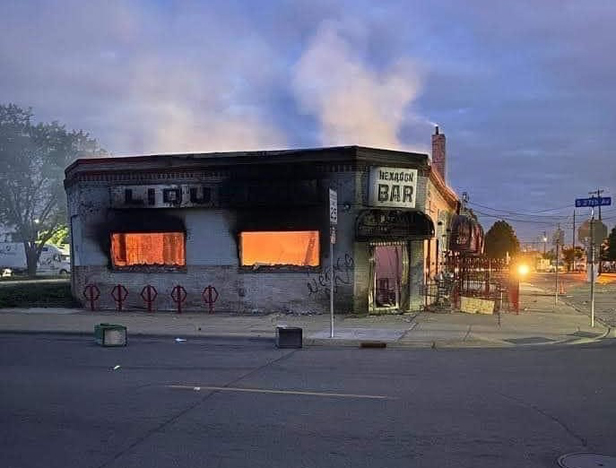
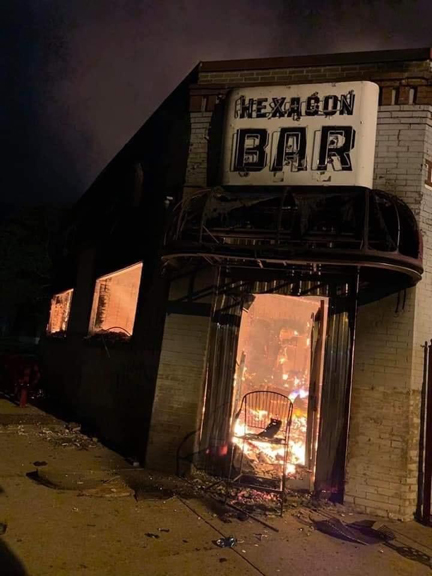
The light of day revealed an empty shell filled with ashes and debris. The roof had fallen into the basement. The Hexagon had been destroyed.
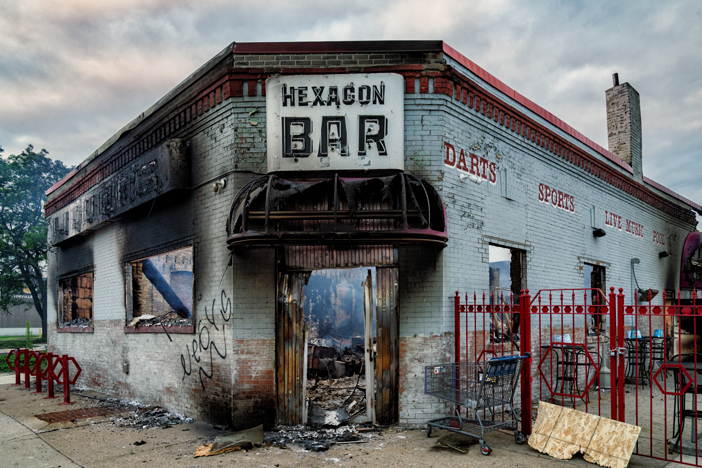
On June 2, 2020, salt was poured into the wound when someone posted this message on the Hex’s Facebook page:
“Due to Arsonist’s [sic] connected with ‘Black Lives Matter’ the Hexagon will be closed until further notice. Plans for rebuilding are in progress. We would Like to ‘Thank our Community’ for all their support and condolences for such an outstandingly shocking, lawless activities that seek to destroy our neighborhood & Community.”
Within minutes, the post was disavowed: “Any previous postings regarding the disaster was not authorized. We apologize for any miss communications.” Then the Facebook page was erased completely. Billy Hupp, Jr., son of owner Bill Hupp, repeated that the offending post was made “without the knowledge of management.”
Hupp, Jr. also said his dad believes he caught the arsonist on a security camera: “A heavyset, white male threw something onto the roof of the bar just before the fire started and surveillance feeds were lost. … It is clear to us that the arson was not made by Black Lives Matter or anyone associated with the BLM movement.”
The Hupps still plan to rebuild and pledged to support the community along the way. “George Floyd’s life was more important than anything that has been destroyed,” Billy Hupp said. “We are looking forward to working closely with the community to heal, learn and support local leaders to ensure equal treatment of ALL citizens.” (Chris Riemenschneider, Minneapolis Star Tribune, June 2, 2020)
The Hideaway was one of the names given to the teen club at the Chicago City Community Center.
The Hideaway was located at 70 E. County Road B in Maplewood, in the vicinity of Rice Street and Highway 36/County Road B.
NORTHWEST SADDLE CLUB
The address shows up as the Northwest Saddle Club in 1963.
In 1968, former Maplewood Mayor Louis P. Gilbert applied for a license to establish a bar in the former private club. He was the owner of Gilbert Construction Co. of St. Paul.
HIDEAWAY
The word “Hideaway” is nigh to impossible to search for, as it most often applies to disappearing beds, but it was apparently there under that name from at least 1973 to 1981. In the early ’70s, Jim and Sharon Tulgren were the owners. (Also seen as Tolgren on Facebook)
Bands mentioned by veterans of the club include:
- Zachariah
- Raggs
- Jesse Brady
- Fragile
- Tickets
- Skyline
- Loafers
- Dame
- Fairchild
- London
- Dareforce
- Straight Up
- Chameleon
- Tune
- Daisy Dillman
- Chameleon
- Fantasy
Beer was big at the Hideaway. 25 cent Wednesdays was one promotion. Susan remembered that they had giant beer mugs that customers took home and then brought back for refills! Bob R sent a picture of his mug! Thanks, Bob!
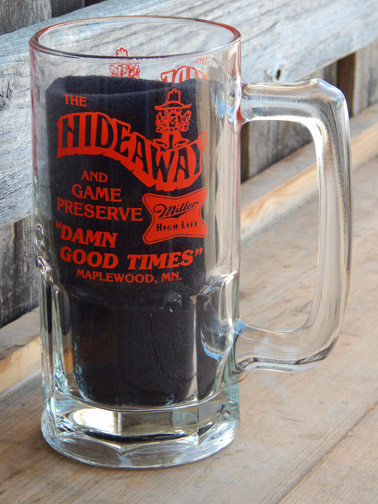
Apparently some national acts came to the Hideaway. Mentioned on Facebook were:
- Black Oak Arkansas
- Elvis Costello
- Greg Kihn
M.T. POCKETS
By 1986 the name had changed, and notoriety was attributed to the bar with the disappearance and murder of Morna Jean Brennan on November 8 of that year. She was picked up by a fellow club-goer named Rickie Kiger, whose advances she had turned down all night.
M.T. Pockets appears to have lasted to at least 1989.
Randy Arneson took some aerial photos around town; these are of the Hideaway taken in March 1999.
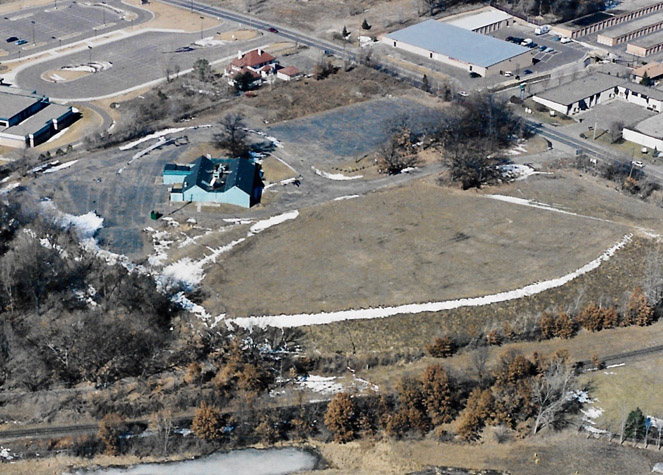
Full view
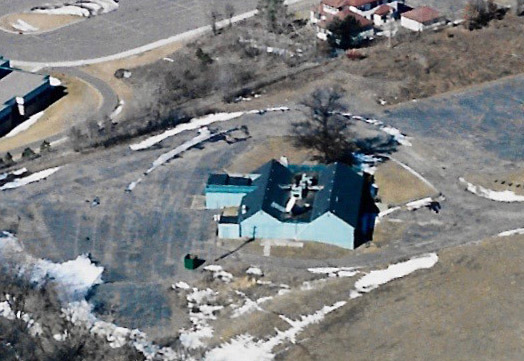
Cropped shot of building
Finally, Alan reports that the Hideaway is long gone: Part of the property is retail and part is the Minnesota Waldorf School. But the folks who survived it with their brain cells intact still have their memories!
Please see the Gay ’90s, Downtown Minneapolis.
136th and Nicollet in Burnsville. Opened in August 1963 with a 30 piece bagpipe band.
The Hilltop Tavern was located at Hoffman’s Corners, eight miles north of St. Paul on Highway 61.
The Grand Opening was on November 18, 1933 – the end of Prohibition. The ad below tells us that the building was previously Bob’s Chicken Tavern. It was a two-story wood frame structure, owned by Henry Hoffman. The word “Orchestra” on the ad gives it its place here.
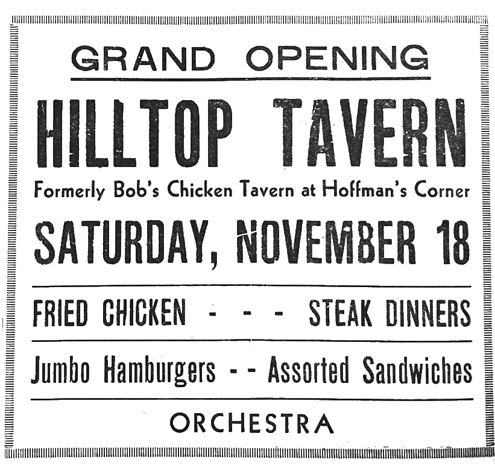
White Bear Press, November 18, 1933
FIRE DESTROYS THE HILLTOP
The only other thing we know is that on June 27, 1937, the building burned down. On June 28, 1937, the Minneapolis Tribune headline read, “Flames Sweep Tavern, Loss is $6,000.” The fire was first spotted by a man waiting for a St. Paul bus, and by Hoffman himself, who also owned a nearby grocery store.
Fire companies were called from White Bear Lake and North St. Paul but were unable to do more than halt the spread of flames because of an inadequate water supply. An unidentified employee of the tavern was asleep on the second floor. Hoffman threw a rock through his window to wake him up, and was rescued through a window by neighbors with a ladder.
The St. Paul Hilton was located at 11 E. Kellogg Ave. in St. Paul. Some of the restaurants were:
- Top of the Hilton
- The Parlour
- The Carousel Lounge
- Don the Beachcomber
- Outrigger
TOP OF THE HILTON
This was a fancy place with a revolving restaurant revealing a spectacular view of the city. People danced, at least in 1970.
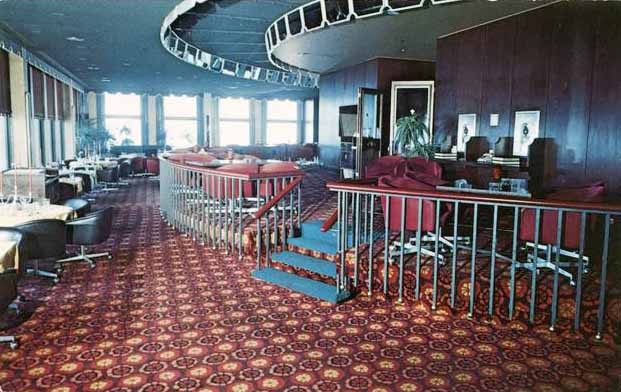
1965 photo courtesy Minnesota Historical Society
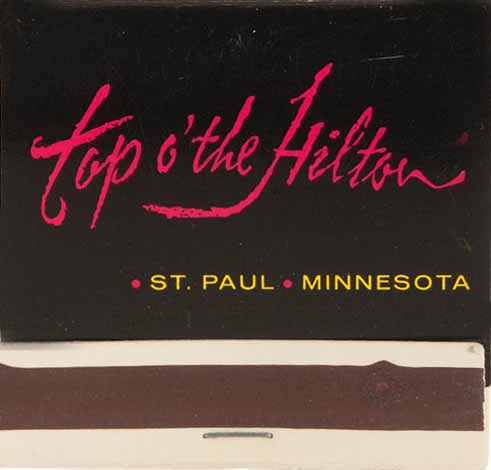
Matches posted on Facebook by Michael Larkin
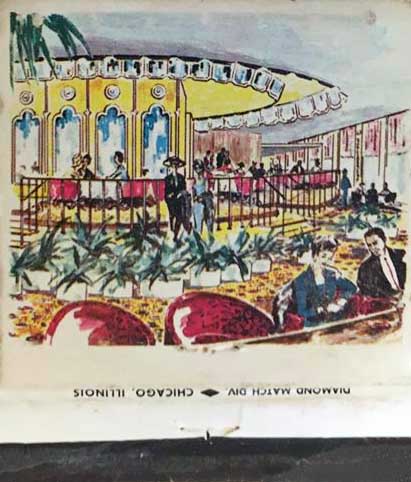
THE PARLOUR
Joe Haupt found this postcard of an opulent – maybe too opulent – little restaurant inside the Hilton that few people on Facebook remembered. It was apparently in business from the early 1970s until about 1976.
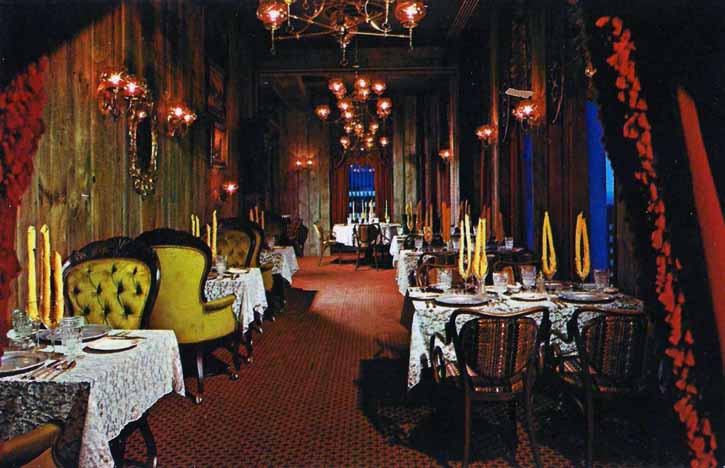
The back of the card reads:
A little bit of old St. Paul… with a beautiful view of new St. Paul. Latest addition to the world of Hilton. Distinctive gourmet cuisine in a gracious and intimate atmosphere.
Two very different perspectives from Facebookers:
The Parlour restaurant was a small area at the Top of the Hilton. It had all its own special Pewter dishes and fancy glassware. They tried to be French cuisine with mixed success. What a pain in the ass for dishwashers!
But this:
My wife and I dined there a couple of times in the early ’70s. You walked across the revolving restaurant and entered the opulent room housing the Parlour. The service and food was absolutely terrific. I was especially impressed when, after finishing our dinners, the waiter stopped by and presented an extensive bagged tea selection for the ladies and a cigar humidor for the gents. What a wonderful experience it was.
CAROUSEL LOUNGE
1969: Billy Wallace Quartet
DON THE BEACHCOMBER (late September/early October 1966)
Although Don the Beachcomber (born Ernest Beaumont-Gantt, who legally changed his name to “Donn Beach,”) was instrumental in opening the Waikiki Room at the Nicollet Hotel in 1952, he opened his own franchise in St. Paul in 1966.
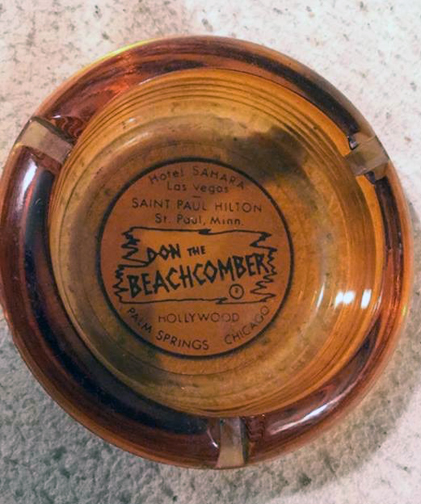
From the collection of Mark Youngblood
I regret to say that I do not know where the following photos came from:
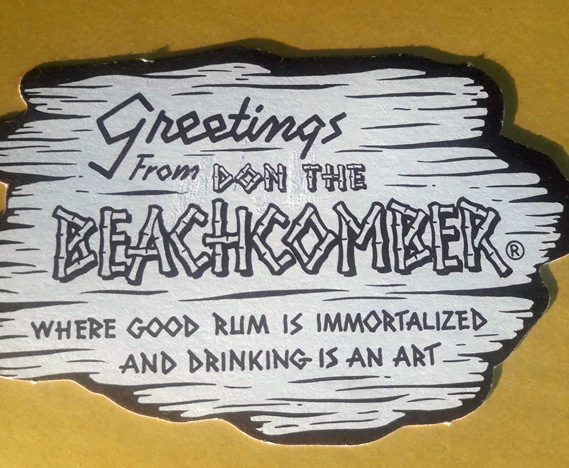
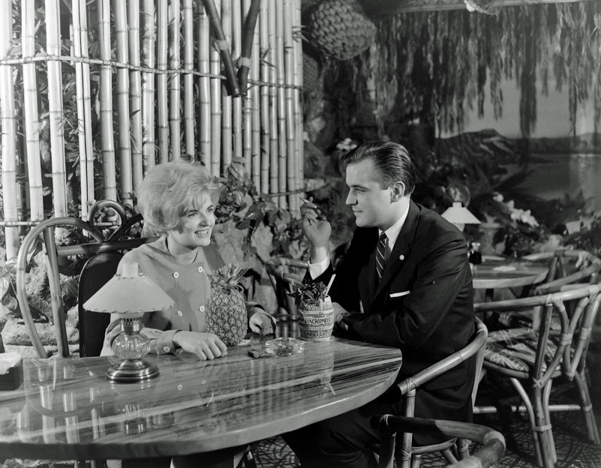
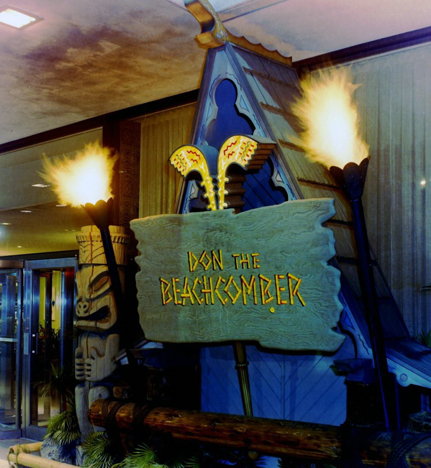
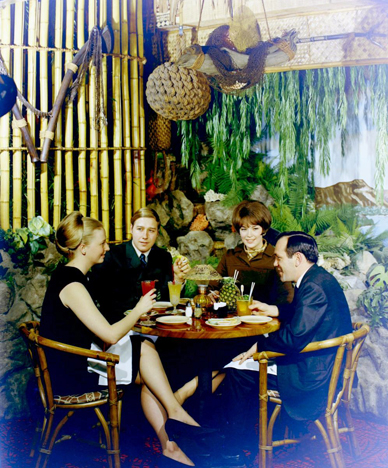
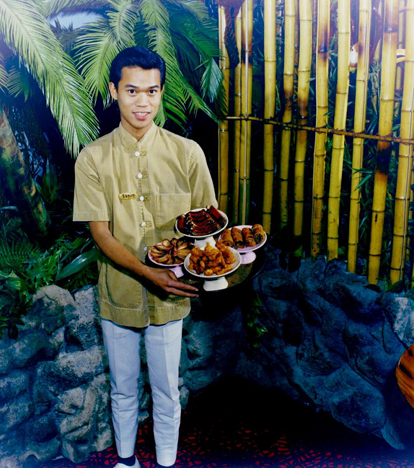
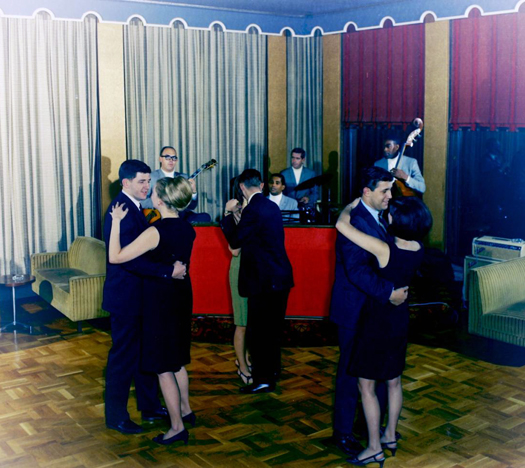
OUTRIGGER
Attached to the 450 Building in Shelard Park (on the walkway between the 400 Building and the Tower) was the Hippogriff Restaurant, “A Very Important Bar Restaurant.”
A Hippogriff is a griffin-headed winged horse.
Burton Grossman of the Grossman Chevrolet family was the owner of the Hippogriff.
Ads for help for the new restaurant were first placed in November 1973. It opened in December 1973. In April 1974 Will Jones wrote a column about the still-new restaurant, which advertised a non-smoking section that turned out not to exist.
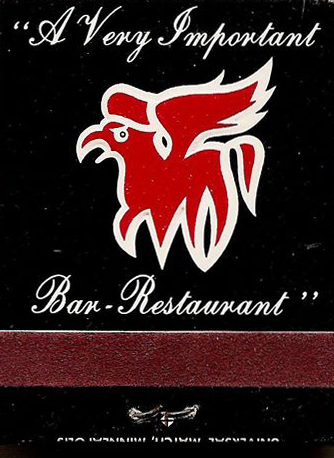
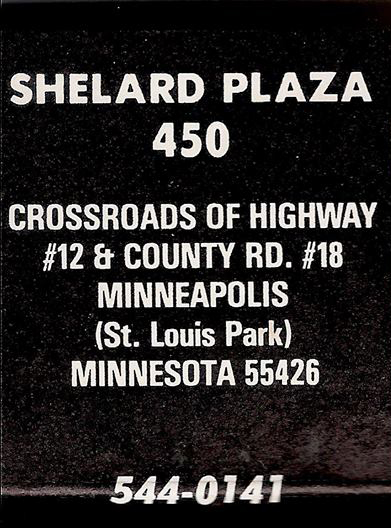
The restaurant was designed by John Neal, Associate Project Corp. of Minneapolis, and won an Institutions/VFM Magazine’s Interior Award.
Karin Winegar in the Minneapolis Star described it like this (May 4, 1979):
With its hovering umbrella-dome ceiling, cushy chairs, bloated booth upholstery, inviting copper and earth tones and tasteful Victoriana, the Hippogriff has a familiar singles-den formula. The Hippogriff is also one of the largest nightclubs in the Midwest. It’s quite comfortable but not highly sensual, much like Maximillian’s in Bloomington (they were designed by the same person)… The quality of the bands varies, but they share a format: jazz and ’40s tunes through the dinner hour evolve at about 9:30 each night into slightly thick but danceable renditions of the top 40 disco tunes and soft rock. The incongruity of the Hippogriff is that it looks disco-esque, but it lacks a disco’s energized atmosphere. Consequently, the haute disco dance troops are elsewhere….On the Hippogriff dance floor, for example, a form of post-Woodstock freestyle predominates, and much of the night traffic consists of baby-fat-coated children of the middle class.
With the story is a picture of the band Parade, but newspaper photos are too dark to be reproduced, unfortunately.
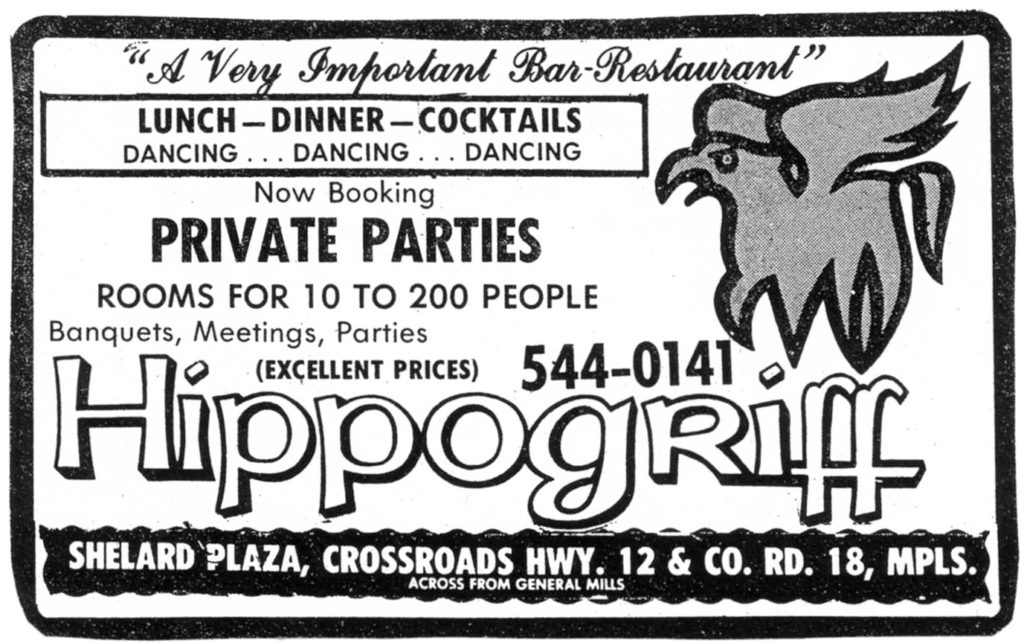
1974 ad
NATIONAL ACTS AT THE HIPPOGRIFF
On August 18, 1974, comedian David Frye was booked as the club’s first big act. Coincidentally, it was on the eve of the House of Representative’s debate of the impeachment of President Richard Nixon, whom Frye was famous for impersonating. If Nixon went, Frye’s career was in mortal danger! (Minneapolis Tribune, August 3, 1974) By the time the date came, Nixon had resigned, and Will Jones’ review revealed a nervous David Frye, but the Hippogriff itself (200 diners and 400 drinks-only patrons) scored high marks. (Minneapolis Tribune, September 8, 1984)
Duke Ellington, January 26, 1975. The band was led by Duke’s son Mercer Ellington.
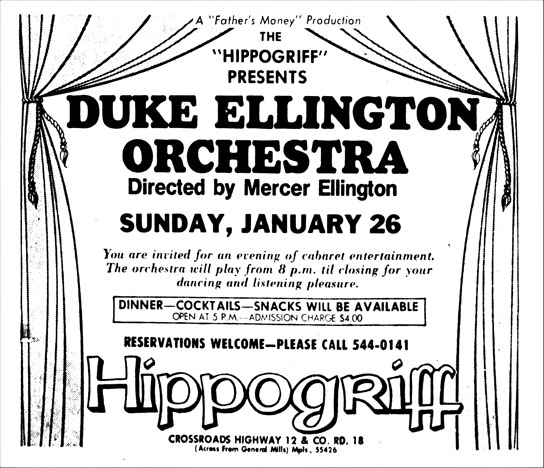
Minneapolis Tribune, 1975
David Brenner, February 23, 1975. “A Father’s Money Production”
Brenner was a veteran of about 30 Tonight Show appearances, and Will Jones deemed his show at the Hippogriff nothing more than chitchat worthy of a warmup show. But the audience ate it up. (Minneapolis Tribune, March 1, 1975)
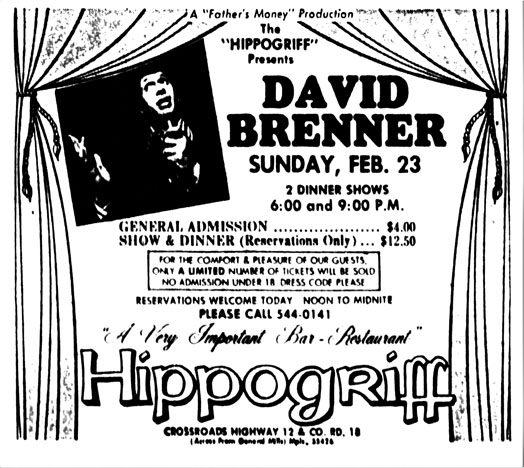
Minneapolis Tribune, 1975
George Gobel, March 16, 1975. “A Father’s Money Production”
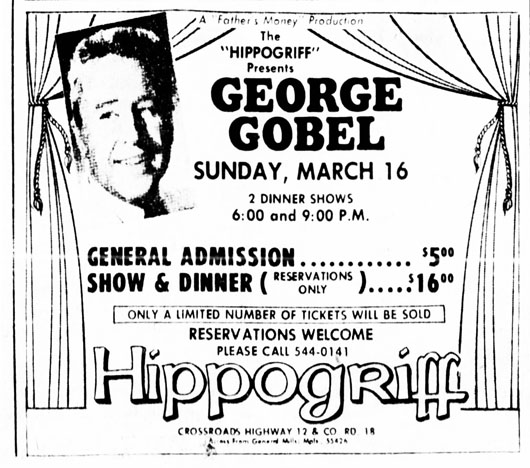
Minneapolis Star, 1975
Oliver, with Timepiece, April 21, 1975. There’s a career killer – two hit records, and he’s billed as singing in the style of someone else!
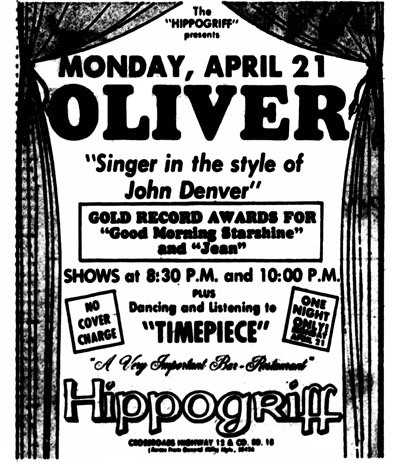
Minneapolis Tribune, 1975
Steve Martin, with the band Timepiece, June 29, 1975. Martin’s debut in the ‘Cities was a warmup act for the Carpenters at Orchestra Hall on May 17, 1975. Jon Bream wrote that he performed at the Hippogriff three times since then before 1978, but I could only find two other shows – he got quite famous quite quickly in 1975. He did perform several times at other venues in town.
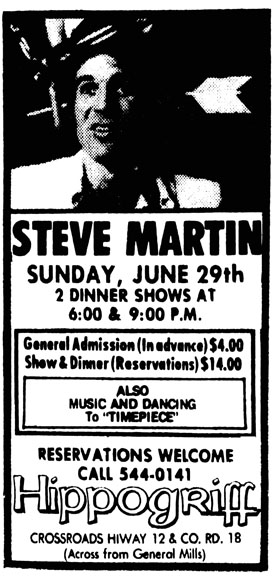
Minneapolis Star, 1975
Steve Martin, September 28, 1975.
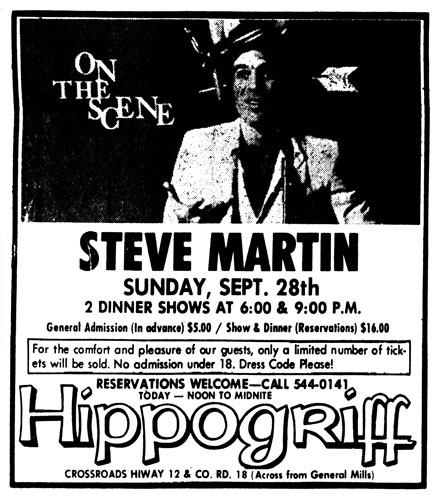
Minneapolis Tribune, 1975
Steven M remembers:
My band Rush Hour fronted Steve Martin at the Hippogriff. I got to be his banjo roadie! We drank brandy, smoked cigars & played pong til after closing.
This report is consistent with his reputation for hanging around with the staff between shows and after hours.
Woody Herman, October 12, 1975
Stan Kenton and His Artistry in Rhythm Orchestra, February 13, 1977
Henny Youngman, November 13, 1977
George Shearing, April 9, 1978
Henny Youngman, with the XL 5, October 8 and 9, 1978. At the October 8 show, 73-year-old Youngman fainted and fell from the stage onto some padded chairs during the first of his two shows and was taken to Mt. Sinai Hospital for examination. Both shows that night were cancelled and Youngman was fine. He attributed the fall to lack of sleep and jet lag.
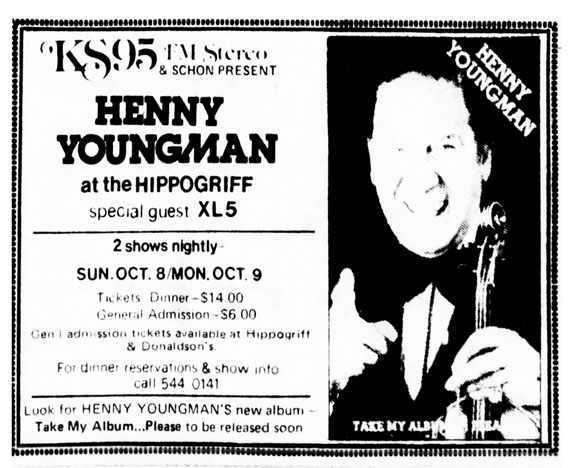
Minneapolis Tribune, 1978
Buddy Rich, September 23, 1979
New Apex Orchestra (of Former Wolverines), December 7 and 23, 1979
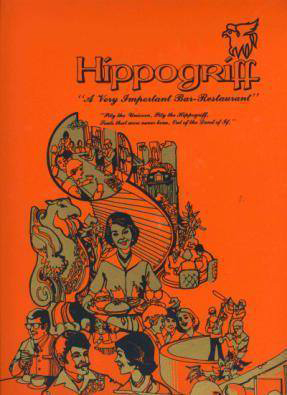
LOCAL BANDS AT THE HIPPOGRIFF:
- Spangle
- Parade
- Mardi Gras
- BeBopper and the Chantilles
- Free and Easy
- Gypsy
- Rockin’ Hollywoods
- Good Vibrations
- Festival
- Nightingale
- XL5
- Fragile
- Rio
- Class Action
- Visions
- Fortune
THE HIPPOGRIFF FIGURES IN MURDER TRIAL
This is gruesome. On October 3, 1978, someone came to the New Hope home of newlywed Susan Rosenthal while her husband was out of town and stabbed her 98 times. With black spray paint, in Susan’s house and on houses in the neighborhood, was written ” There will be more” and “You are next.”
Suspicion was immediately pointed to June Marie Mikulanec, described as a former girlfriend of the victim’s new husband, Allen Rosenthal. June’s alibi was that she was at the Hippogriff, where she met a man named Phil, new to the Twin Cities. They went to a nearby McDonald’s, and came back to the club to talk until 1 am.
June was arrested on October 7, 1978, and examined by psychiatrists. Under truth serum she revealed that she talked to God, Jesus, and other deities, and what really happened is that she and Phil went to Susan’s house, where Phil stabbed Susan and made June stab Susan five times or he would kill June too. (This is right out of Manson.)
June was revealed to be an uncontrolled liar, and was put on trial in August 1978. October 3, 1978, was a slow night at the Hippogriff, and none of the staff remembered her there. Directions to Susan’s house and cans of spray paint were found in her car. Phil was one of many, many people and things she made up. The jury had two findings to make: Did June Mikulanec murder Susan Rosenthal? Answer: Yes. Was she in her right mind when she did it? Answer: No. She was found Not Guilty by Reason of Mental Illness and sent to State facilities for the criminally mentally ill. Ugh.
THE CURIOUS END OF THE HIPPOGRIFF
The Hippogriff closed without notice on July 31, 1980, leaving some with reservations for wedding receptions out in the cold, reported the Minneapolis Tribune on September 4, 1980. Burt Grossman was said to be “on vacation” an unavailable for comment.
PAULINE’S
The Hippogriff subsequently became Pauline’s, which was owned by brothers Richard and Paul Mans, who had a similar restaurant in Brainerd. A 1981 ad says “Starting July 6, dance to the music of Areca, Oui Four and Visions. Pauline’s: What a Nice Surprise!”
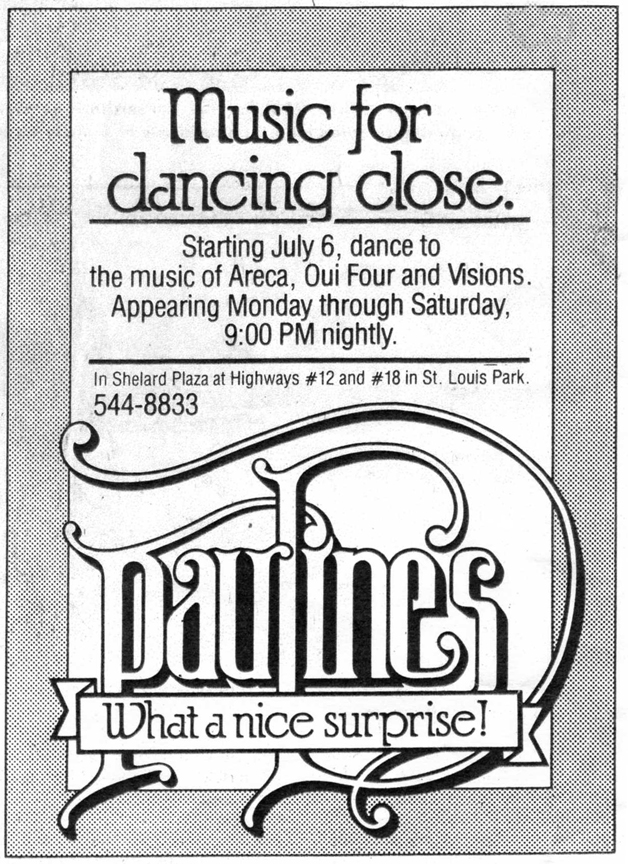
Please See the Foshay Tower
Musical Entertainment and Dancing, 1963.
(St. Paul?). 1963: Musical Entertainment, Piano Bar, Dancing.
Not affiliated with the Holiday Inn motel chain, the Holiday Inn Tavern was located at 3960 Minnehaha Ave. in Minneapolis. It was owned by Thomas L. Knott.
BUILDING HISTORY
The building was built in 1918; a 1922 ad indicates that it was a Rochdale Consolidated grocery store.
In 1930 the Falls Department Store was closing out.
HI HO CLUB
In July 1933, at the end of Prohibition, Simon H. Eustice applied for a dance hall license, but neighbors objected to the Hi Ho Club. Apparently the issue of whether to allow dancing where beer is sold had not yet been worked out, and although an alderman had not noticed any undue noise at the Hi Ho Club, the dance hall license had not yet been approved, so police stopped the dancing. (Minneapolis Star, August 24, 1933). In October 1933 the dance hall permit was denied.
FALLS EAT SHOP
By April 1934, Earl C. Paddock was the owner of the Falls Eat Shop and had a 3.2 beer license. In December 1935 he had licenses for “amusement devices,” which were probably juke boxes and pin ball machines.
FRANK PADDOCK’S TAVERN
By January 1, 1943, the place was called Frank Paddock’s Tavern. In January 1940, Frank Paddock and 11 other defendants had been charged with maintaining gambling devices – “14” games and pinball devices – he at his tavern at 907 W. Lake Street. They were all sentenced to 30 days in the Workhouse, but on appeal their sentences were reduced, his to $100. Paddock’s wife’s obituary says that they owned the tavern on Minnehaha for 20 years before they sold it, bringing it back to 1937. Which doesn’t compute if he had a tavern on Lake Street in 1940, unless they had two licenses. Frank died in 1990, and his wife Orpha in 1994. (Star Tribune, October 19, 1994)
On August 25, 1957, the place was advertised for sale.
PEASANT INN
On June 13, 1958, two ads for a “Barmaid” called the place the Peasant Inn.
HOLIDAY INN TAVERN
The first listing for the Holiday Inn Tavern, in the form of a wantad for a waitress, can be found in the Minneapolis Star on April 24, 1959.
In the summer of 1959 the bar had a softball team.
Musical acts included Sherwin Linton and the Fender Benders playing rockabilly.
On September 28, 1960, the Minneapolis City Council licenses committee heard from residents and/or merchants in the area of the bar, complaining of “disorderly conditions: drunken persons, fights, and litter,” creating a nuisance. The committee recommended revocation of the bar’s 3.2 beer permit.
SHORT LIFE
On October 28, 1960, the building was put up for sale for $15,000. It was vacant and for sale for over a year until taken over by Minnehaha Surplus and Hardware. That went out of business in May 1966.
The next owner was the U.S.S. Yorktown Post and Auxiliary 178 Veterans of Foreign Wars from 1966 until 1979.
The building is now the Minnehaha Business Center.
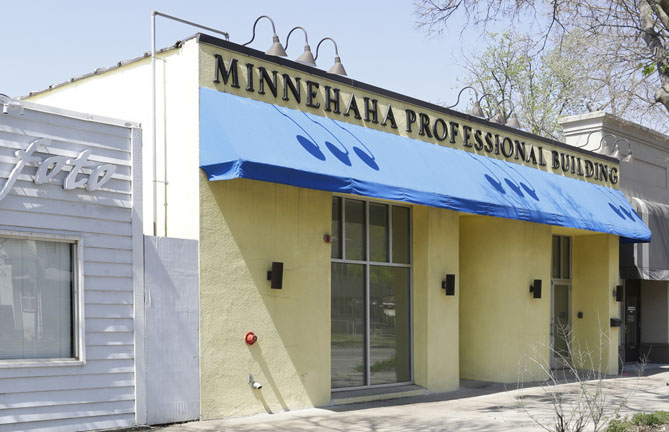
Cedar Ave, West Bank. Polka in the back room in the ’60s.
This page covers two important venues in the same building in Mendota:
- The Hollywood Inn
- Mitch’s of Mendota
THE HOLLYWOOD INN
Many thanks to Jeff Neuberger for his contributions to this section!
The Hollywood Inn was a nightclub and gambling casino located at the far end of the Mendota Bridge. It opened in about 1928, during Prohibition.
“Dapper Danny” Hogan was one of the original owners, and rumor has it that his car bomb death had links to his not paying Harry Sawyer his cut from the Hollywood Inn.
After Hogan’s explosive end, the Inn was run by Fred C. Ulrich, his brother William “Curly” Ulrich, a former boxer, and John “Red” Clare.
A search through the Minneapolis papers shows that in September 1928, the Governor and the Attorney General had a conference on a report of gambling at the Hollywood Inn, but no reports were released as to the outcome of the conference.
An early raid took place by the Dakota County Sheriff on September 21, 1932, where three roulette wheels, two blackjack tables, and several poker tables were found in the basement. “Patrons of the dining room danced on during the raid and were not molested.” However, the establishment was padlocked the next day. Proprietor Joe Clare was arrested for maintaining and operating a gambling device, as was Fred Ulrich when he surrendered on the 24th. Joe Casey and William Buckman also gave up the ghost on the 24th, and were charged with operating a gambling device. In October 1932 they were assessed $200 fines for each charge.
Another raid ensued on June 27, 1935, when a truckload of gaming devices was seized from the place. Initially arrested were Frank R. Sullivan and George McKinley, the operators of the Inn. Apparently a judge had allowed the place to reopen under new management. Later it came to light that Fred Ulrich and Joe Clare were also caught at the raid, in their capacity as owners of the property. Sullivan and Ulrich were each fined $200 and given suspended 30 day sentences.
There was another Hollywood Inn in St Louis Park.
MITCH’S OF MENDOTA
Much of the information about Mitch’s comes from an article by Bob Murphy in the Minneapolis Star, dated October 24, 1950.
Mitch’s opened in 1939 as a 3.2 beer tavern (a/k/a Mitch’s Cafe) owned by Herman Mitch. Set-ups were also bootlegged from the kitchen. Mitch had either owned or managed the Silver Strip on University Ave. in St. Paul and had featured William “Red” Dougherty on the piano there. When he bought Mitch’s in Mendota he brought Red with him, and Red’s was the first Dixieland band of its kind in the area. Other members of the band were Don Thompson on trombone, Harry Blons on reeds, Ed Tolck on drums, and singer Norma Terry.
Every Sunday Red’s group played for an hour from Mitch’s over the radio with Leigh Kamman as emcee. The group also performed over the air for fifteen minutes each evening. Mitch’s was also a spot for after-hours jam sessions, and at times would host Hoagy Carmichael, Jack Teagarden, members of Red Nichols’ and Woody Herman’s bands, Ray McKinley, Gene Krupa, and others.
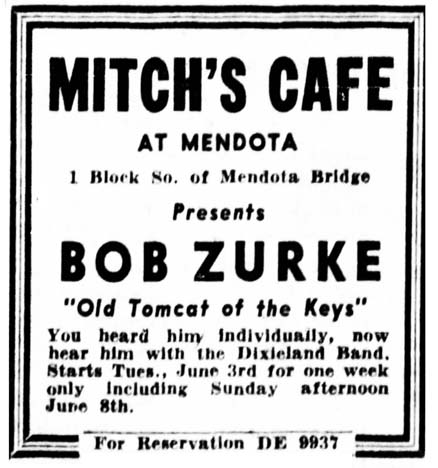
Minneapolis Star, June 1, 1941
World War II broke up the band, however. In fact, in a 1960 article, Leigh Kamman said that the War temporarily closed the music business in this part of the country.
Mitch leased out the place and in about 1943, he was said to have received a loan from gangster Tommy Banks to start the Casablanca night club at 408 Hennepin Ave. He took Red Dougherty with him as well.
In 1948, Bob Mitch, Herman’s son, took over Mitch’s. The house act was Harry Blons and his Mendota Buzzards. Other members included Bob Gruenfelder on trumpet, Hal Runyon on trombone, Harry Norling on bass, Lew Holtman on piano, and Warren Theus on drums. “Once again live jazz began to flourish.”
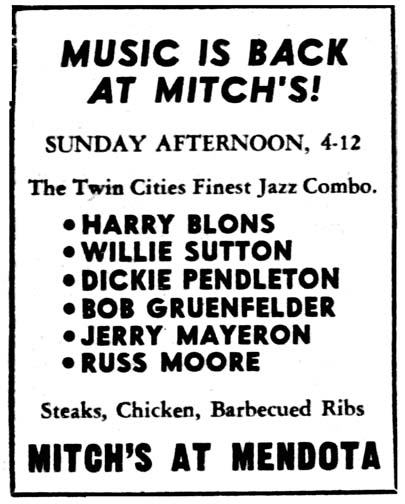
Minneapolis Tribune, July 17, 1949
An ad in the September 1949 issue of the St. Paul Musician (organ of the St. Paul Musicians’ Union) named the members of Mitch’s Dixie Land Band as:
- Harry Yablonsky
- Bob Gruenfelder
- Dick Pendleton
- Lyle Smith
- Willie Sutton
- Jerry Mayeron
Sunday night Dixieland sessions resumed at Mitch’s in October 1949.
In February 1950, a Sunday afternoon Dixieland radio show called “Dixieland Caravan” made its debut on radio station WMIN, hosted by Leigh Kamman. Featured were music by Harry Blons’ band, and songs by Patty McGovern (Kamman’s wife) and guests. (Minneapolis Tribune, February 3, 1950)
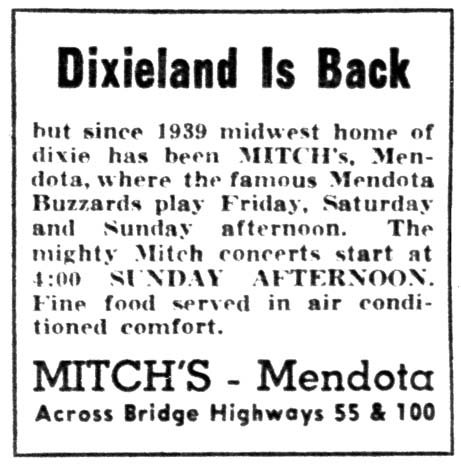
Minneapolis Tribune, July 29, 1950
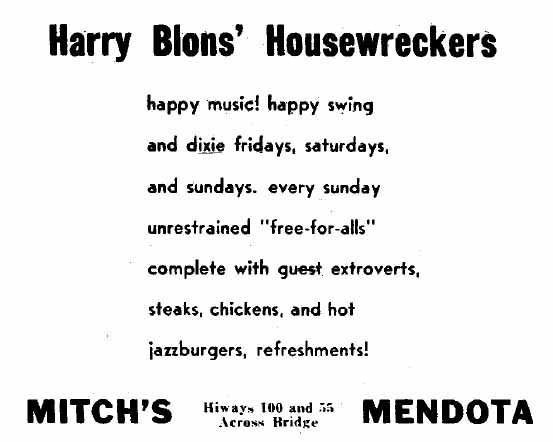
Undated ad from the Minnesota Daily, courtesy Robb Henry
THE BULLDOZER TAKES MITCH’S
On November 1, 1950, the old Hollywood Inn/Mitch’s building was closed for good and the frame building was demolished to make way for a highway cloverleaf for Highway 110. A farewell Halloween party was attended by about 500 people, reported the Minnesota Daily on November 2.
The photo below is identified as Mitch’s by MHS, but there are two buildings there, so I couldn’t tell you which was Mitch… The Minnesota Daily article called it a “beat-up, white frame roadhouse, so I’m guessing it’s the one on the right.
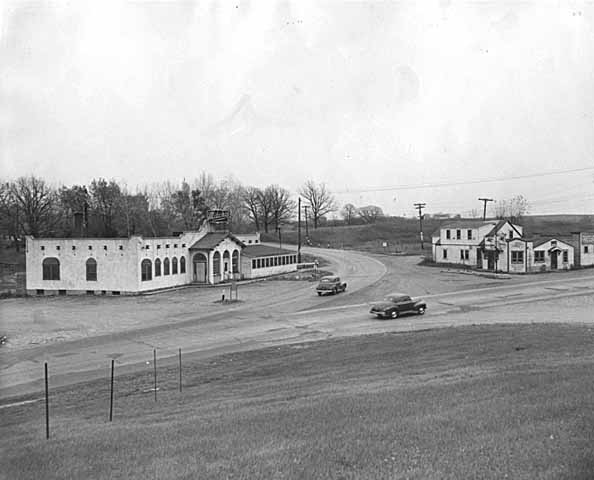
Mitch’s Tavern, October 31, 1950. Photo courtesy Minnesota Historical Society
In addition to the Hollywood Inn in Mendota, there was briefly a Hollywood Inn in St Louis Park, a first-ring suburb just west of Minneapolis.
It was located at 6001 Excelsior Blvd., in a building that would become most memorable as Brookside Drug, built in 1915. That building, still there, is on the Southwest corner of Excelsior Blvd. and Brookside Ave.
HOLLYWOOD INN
In 1926 Harry J. Luscher applied for a permit to operate the Hollywood Inn. It was during prohibition, of course, so the establishment was a restaurant and soft drink parlor. (This is not to be confused with the more notorious Hollywood Inn in Mendota.)
In July 1926 the Hollywood Inn offered a “7 Course Table de Hote dinner, fresh fish daily, Dinner served all day Sundays. Music. Harry formerly of Bergsings Cafe.
On May 18, 1927, the Brookside Brotherhood of the Brookside M.E. Church protested the granting of a license for dancing, presumably in vain.
In 1928 Mr. Arthur M. Bredeson received his annual permit to run his cafe in March.
In March 1928 there was a notice that the Hollywood Inn was for lease, and the next month an ad showed that it was under new management.
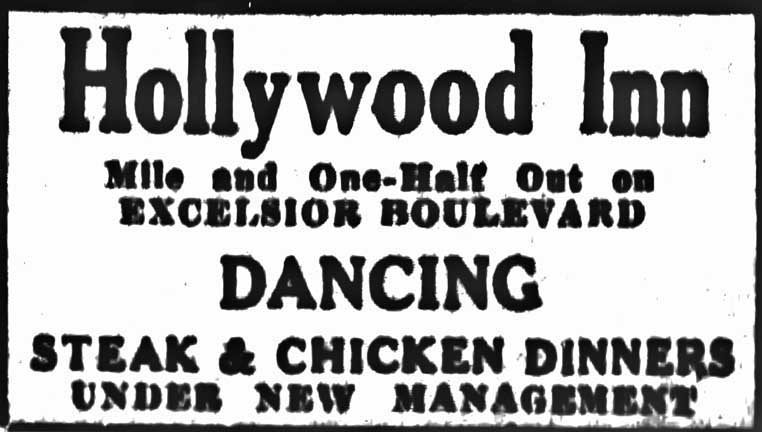
April 13, 1928
In June 1928 there was a petition to the Village Council to allow dancing, although by the looks of things (above), the folks were already doing so.
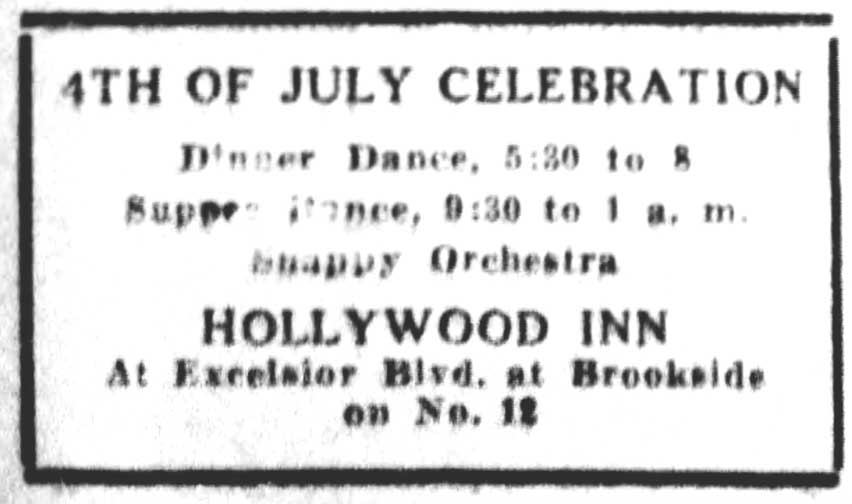
July 1928: “Snappy Orchestra”
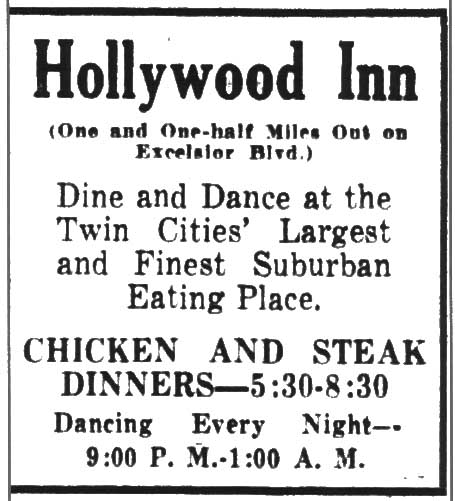
July 27, 1928
Now, I grew up in this neighborhood, and that building was NOT very big. So if this was the “largest and finest suburban eating place,” there was either a lot of hyperbole in the publicity department, or they hadn’t been across the street to El Patio. But swell.
Hollywood Inn ads seemed to stop in July 1928.
In March 1929 Mr. C.H. Kavalaris wanted to open a restaurant at the site of the Hollywood Inn. (An entry for the Hollywood Inn on a building permit for the El Patio address across the street dated March 28, 1929 indicates that the establishment known as the Hollywood Inn was a barbeque place, and the owner was listed as Ed Nolan.)
In 1931 L.M. Duff requested a permit to operate a restaurant. So did Elliott Anderson, who wanted to serve lunches, pop, and milk.
COZY CORNER
In March 1933 a Mr. William F. Zahn requested a license for a restaurant and beer parlor, making the Cozy Corner one of many, many beer parlors that were unleashed at the end of Prohibition.
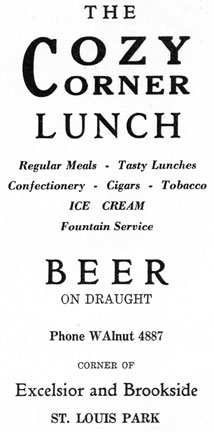
BROOKSIDE INN
In March 1934, henchmen for Baby Face Nelson mowed down local resident Theodore Kidder with machine guns at the corner of Excelsior and Brookside. Bullet holes were embedded in the stucco and were evident for many years. We know from the murder coverage that the place was called the Brookside Inn restaurant/cafe and confectionery, C. Wesley Smith, proprietor. Mr. Smith had obtained a license to expand for music and dancing.
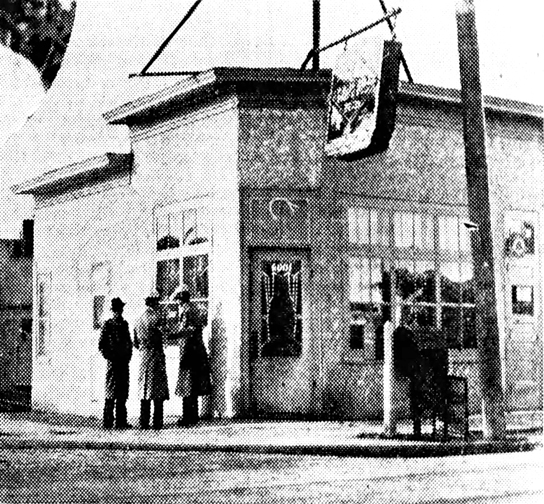
Brookside Inn, March 1934, after Kidder shooting
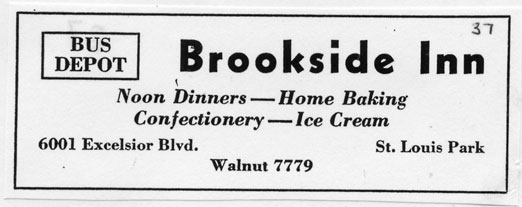
VENETIAN POOL
In the 1934 Directory the building was also advertised as the Venetian Pool, “The Beauty Spot of Excelsior Blvd.” Advertising language (“Marvelously Prepared Food, Refreshing Drinks”) was the same for both, leading us to believe that the inside was the Brookside Inn and the famous outside beer garden in the back (along Brookside Ave.) was the Venetian Pool. Beer had just become legal again, and this popular Beer Garden had tables with umbrellas in back when the weather was nice, and colorful lights strung for the ceiling. This setup particularly scandalized the neighborhood, since now Little Johnny could actually SEE people drinking beer, instead of just imagining what they were doing inside El Patio across the street.
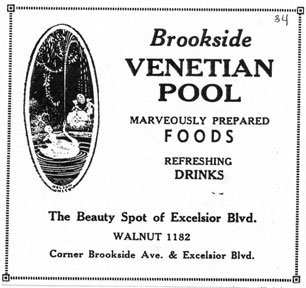
The new liquor ordinance prohibited minors to be in beerhalls, but parents protested that their children could no longer work there, so each parent had to individually request permission for his child to work. On May 2, 1934, Mr. P.K. Anderson received permission from the Village Council for his daughter Evelyn to work at the restaurant.
VENETIAN GARDENS
The ad below from the Hennepin County Review is date June 20, 1935. The place may have changed owners soon after; on November 25, 1935, Olav Vik and George Hanson applied for a beer license for their restaurant but were (at least initially) denied. Vik received approval on February 3, 1936.
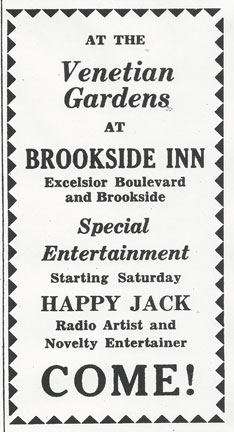
1933 Lyndale Ave. So. has been the home of several establishments.
In 1925, during Prohibition, it was a delicatessen that served lunch and soft drinks.
In 1929 the establishment, still a delicatessen, was owned by Alice Barquist. In March 1931 it made the news when a Mr. William Watson, pretending to be a future heir of a fortune, ran up a $523 bill at the deli and it was discovered that he was a fraud.
On April 6, 1933, the first day after beer was legal, Alice had her on and off-sale liquor licenses and a restaurant license. That November she advertised for a cook, “Scandinavian preferred.”
In 1936 the licenses were issued to John L. Garrett.
THE GABLES TAVERN
The first time a Strib search finds the Gables Tavern is in 1945.
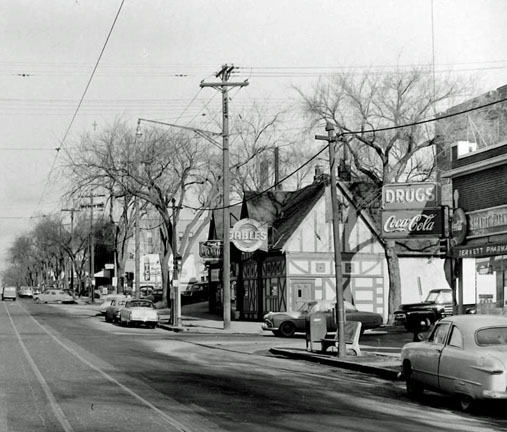
Gables, December 11, 1953. Photo courtesy Lyfmap
On October 19, 1967, owner Jerry J. Ager had to shut down and re-apply for his beer license after failing to pay the license fee due October 1.
In 1969 the house band was XL5.
In October 1970 the Gables Tavern went country.
THE HOUSE OF GABLES
Became the House of Gables in 1970, owned by Jim Boosalis.
THE HOME SALOON
Still owned by Jim Boosalis when the name changed. In May 1971 Frank Marino was the new owner and Jason Kennedy, manager.
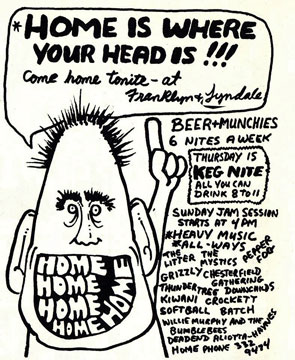
Insider ad, 1970/71
FOOL’S PARADISE
An article from April 23, 1974, about a man who hung himself in the Hennepin County jail after being arrested for stealing two pairs of sunglasses revealed that 1933 Lyndale had been a bar called Fool’s Paradise on April 15, 1974.
RUDOLPH’S
Barbeque Place, owned by James Theros. This location opened on June 20, 1975.
In 1983 Rudolph’s won three trophies in a restaurant rib contest in Cleveland. The operations manager was Tommy Retanas, who had come to the U.S. from Thailand. After working at Rudolph’s for three months, Theros decided to sponsor him, and then adopted him. At the time there were two other Rudolph’s at 815 E. Hennepin in Minneapolis and 475 Fairview Ave. in St. Paul.
James C. Theros filed for Chapter 11 reorganization on October 11, 1995.
In 1997 the food got a terrible review by Strib food critic Jeremy Iggers.
Theros remodeled the place every five years the Lyndale store was open. Music was presented on weekends.
SnellClair Inc., also known as St. Clair Broier, filed for Chapter 7 bankruptcy (liquidation of business) on October 19, 2017. Charles J. Theros was listed as President.
Rudolph’s closed on July 25, 2018.
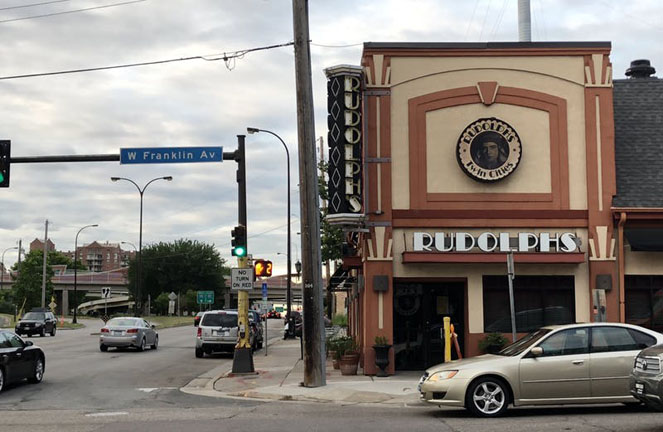
Photo by Emily Cassel, City Pages
Save
This was a north Minneapolis club that opened and closed within two weeks. Pianist Peter Nero had been signed to perform there in 1962, and as a result of the club’s closure he only got partial payment. Claiming he was owed $1,237, the Minneapolis Musicians Local 73 sought payment by ordering its members not to play at the Gay Nineties, which was owned by Richard Gold, a member of the board of directors of the company that hired Nero. The dispute was settled out of court for “less than $1,237.” (Tribune 12/10/63)
2636 Portland Ave. So., Minneapolis. This came to be an R&B venue when KUXL Program Director Jack “Daddy Soul” Harris, who worked at Honeywell, was looking for a venue to hold dances. The Jackie Awards were held here on August 30, 1969.
150 No. Concord, So. St. Paul. Country bar in 1973.
The Hopkins House actually included three different venues, according to their matchbooks:
- The original Hopkins House, located at 1501 Highway 7 in Hopkins
- A second hotel in Golden Valley, located at 4820 Highway 55
- The Breezy Point Resort, apparently owned by the same people for a time
HOPKINS
The Hopkins House restaurant opened in 1948 and the Motor Hotel opened in 1963. In his column dated May 1, 1963, Will Jones said that BeBe Shopp, Hopkins’ own Miss America, was being paged to come and open the facility.
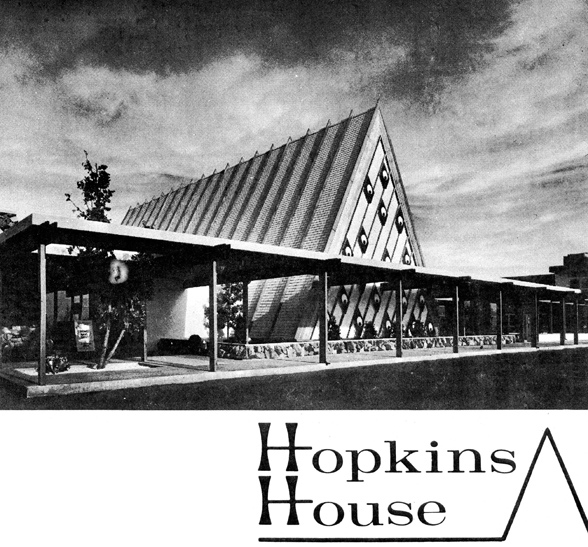
1965
Venues within the hotel included:
Madiera Room
In 1963 Jones described this as a fancy dining room.
Presumably it was here in 1965 that they had “discotheque dancing” on Tuesdays during happy hour (“Colossal Cocktail Hour”) and Wednesdays during orchestral intermissions.
Eye of the Rib
Jones described this as a less fancy restaurant. A 1965 ad boasted an open charcoal broiler.
Black Pearl Cocktail Room
In September 1966, La Lani brought Polynesian Interpretive Dancing to the Black Pearl to spice up your Wednesdays.
January 1969: Kaye Brothers, back that July
March 1969: Jan Ames
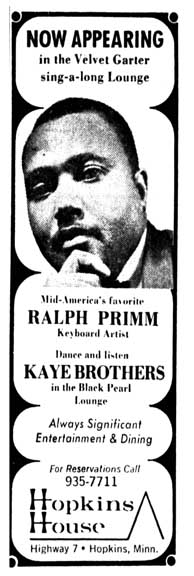
Minneapolis Tribune, January 24, 1969
Velvet Garter Sing-a-Long Lounge
This was a piano loft tucked up into the rafters of the A-frame building, according to Will Jones.
In 1967 to 1969 there was the “fun, fun Velvet Garter sing-a-long Lounge.”
Ralph Primm held forth in January to March 1969.
Rob Trebor entertained in July 1969.
In 1973 the entertainment was billed simply as the Italian Show Band.
A 1965 ad described two banquet rooms, each with a capacity of 75, and a Hall of Seasons Banquet Room that could seat 550. There was also a 60′ by 220′ exhibit arena with a drive in ramp.
The restaurant building was connected to the 64-unit motor hotel by a glass corridor. The hotel had a pool. By 1976 there were 171 rooms.
Adjacent was the Hopkins House Shopping Center, with a liquor store, convenience store, barber shop, beauty parlor, and Pure Oil gas station.
GOLDEN VALLEY
A Hopkins House – in Golden Valley? Apparently so. This Hopkins House that was not in Hopkins was new in July 1967.
The Rural English Plank ‘n’ Platter Dining Room
Ha’Penny Bar/Lounge
March 1969: Tommy Francis, Lelani
The motel had 110 rooms and a pool. The location appears to be two senior living facilities now.
BREEZY POINT, BRAINERD
The only reason I can think of as to why there was a Hopkins House in Brainerd would be that they had the same owners and they wanted to cross advertise. An ad from 1968 declares, “Now There are 3!”
Please see Dick’s Horseshoe Bar.
This is the story of the building at 400 Auditorium Street in St. Paul.
Never heard of Auditorium Street? Michael Larkin of the Old St. Paul Facebook page reports that “Auditorium Street ran North/South from the old St. Paul Auditorium to the area where the old White Castle was on W Seventh. The street was wiped out in urban renewal.”
It was originally called Franklin Street. Kevin Carlson posted this helpful map:
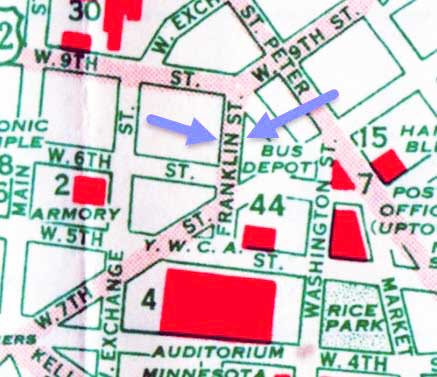
Image courtesy Kevin Carlson
What little I could find out about the building isn’t much:
JOHNNY MAUER’S BAR
On May 1, 1962, it housed Johnny Mauer’s Bar and Bowling Alley, and suffered a devastating fire.
THE SHERWOOD LOUNGE
The building was reconstructed inside the brick walls, and in 1963 it was the Sherwood Lounge, Donald Mauer, Proprietor.
THE RED CARPET
In mid-1966 George Schaumburg opened The Red Carpet. Schaumburg was involved in many establishments in the ‘Cities, including George’s in the Park, George’s in Fridley, the Office, and the Flamingo.
The Red Carpet was divided into the dining room and the Cock-a-Too Room. Here’s what it says about the latter:
Where action and the “in” crowd meet. Come and be part of the big sounds that originate six nights a week in the Cock-a-Too Room. If you enjoy a dance, a fine cocktail, or swinging with the swingers . . . why not make yourself part of the scene! Meet the lively ones where it’s refreshingly “different!”
Vicki and the Tornados started playing at the Red Carpet shortly after it opened in 1966. Vicki Victoria says, “The opening night act was “Mudcat” Grant—who knew he could sing!” They performed there four nights a week for about one year. The group was featured in a full-page ad for the establishment in the July 7-13, 1967, issue of See Saint Paul, a magazine telling visitors where to go and what to do (George Shearing was starring in the summer pops jubilee and was on the cover of the magazine).
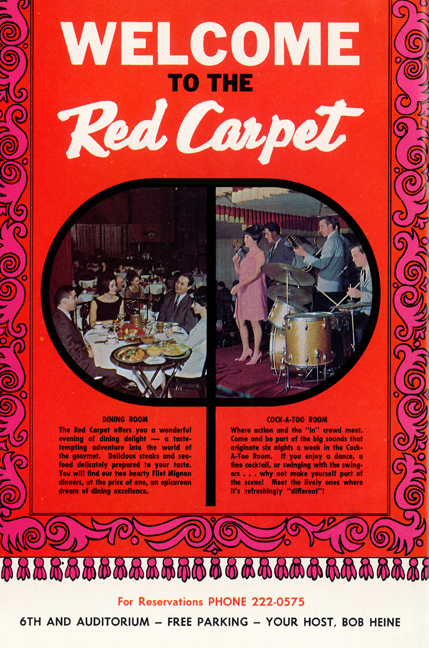
Information and image provided, with thanks, by Vicki Victoria: http://vickivictoriagilmer.com/
FLASH! The band in the picture on the left is Denny and the Tornadoes! Or the Toronadoes, depending on who’s writing the ads. Here’s a closeup:
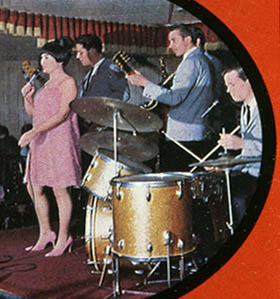
Image courtesy Tornado Jack Doepke
THE HOSPITAL LOUNGE
In one of the sillier concepts I’ve read about, the Hospital Lounge out-themed every other club in town. Will Jones said, “Its owner, promoter Bob Heine, apparently decided to face reality and supply the place with a theme in keeping with the over-all grimness of downtown St. Paul after dark.” This fine institution opened for patients in January 1969.
Some features:
- The main entrance was labeled ADMITTING.
- The downstairs bar was called the PHARMACY.
- The toilets were labeled EMERGENCY.
- The downstairs dining area was called the RIB ROOM.
- Behind the bandstand a sign requested QUIET.
- The upstairs room “where young folk meet for group therapy to the background of rock music” was called the OPERATING ROOM.
- The waitresses were dressed in mini nurses’ uniforms.
- Surgical masks were handed out as favors.
- The medical symbols for male and female were on the restroom doors.
- “I had 1,000 thermometers to use as swizzle sticks, but somebody stole those,” said Heine.
Heine also pointed out that there were five hospitals in the area, so “we have a lot of real nurses coming in here.”
Jones noted that the downstairs crowd was listening to a Dixieland band, and suggested the room be renamed Intensive Geriatric Care. His comments on the goings-on upstairs were pure Jones, and I will quote him at my own peril:
Upstairs in the Operating Room there was some experimentation with a derriere transplant. A callipygian waitress named Shari wiggled out of her nurse uniform and into a go-go costume to frug along with Dennis Sundlie and the Toronadoes, thus auditioning for a promotion from the floor to the stage. “She does something for my tired blood,” mused Heine.
Alas, the fun was over quickly. On March 26, 1969, a four-alarm fire sent 14 rigs to the scene and 100 people were routed from the building. The fire moved so fast that the musicians lost their instruments. It apparently began in the basement, burned through the first floor and went up a staircase to the second floor. There were no injuries and no need for a hospital. Jean Day found a photo!
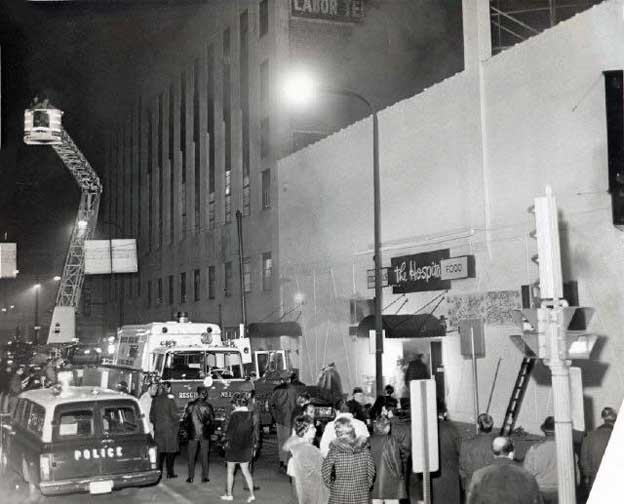
Photo courtesy Ramsey County Historical Society
The Hotel Hastings was located at 32 North 12th Street, in Minneapolis.
It was built in 1911 for $140,000, and given its name by the owner to impress a girl he was dating who was from Hastings, so the story goes. It rose six stories high and was made of brown brick.
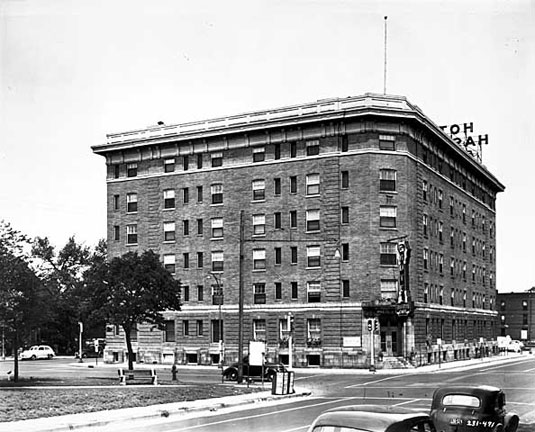
1948 photo courtesy Minnesota Historical Society
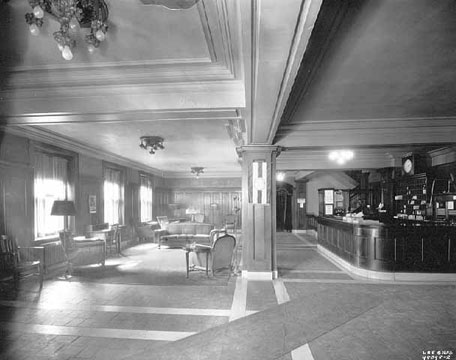
Inside view, 1930 – Minnesota Historical Society
Some of the venues within the hotel were:
BLOSSOM ROOM
Ads for the Blossom Room start to appear in 1950. It does not appear to be a music venue, but merely a restaurant.
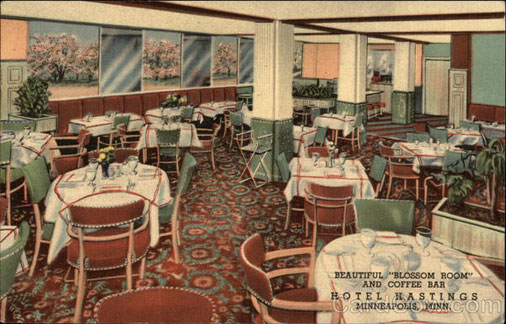
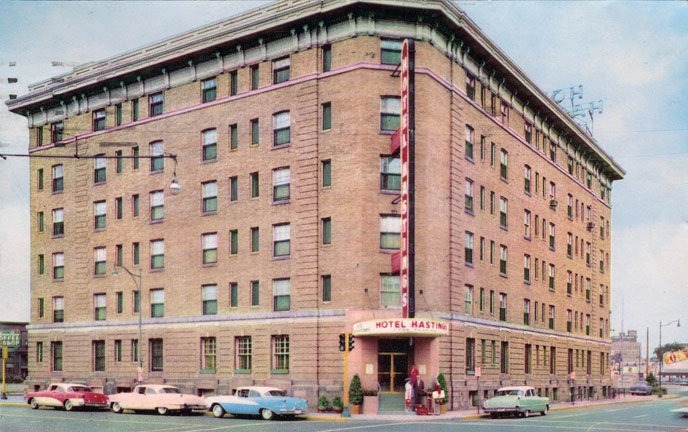
Photo courtesy Alan Freed
Jack Dow bought the hotel with partners Wheelock Whitney and Cedric Adams in 1959.

Jack Dow
MAR-KEY CLUB
The Mar-Key Club was a “Key Club,” i.e. a private club that required patrons to pay an annual membership. It opened in May 1961, at the height of the Key Club fad. It was advertised as “Minneapolis’s most exclusive club.”
In 1962 the club featured palmist Nonette; columnist Vic Burton of the Minnesota Daily Herald recommended washing your hands before you go for an accurate reading.
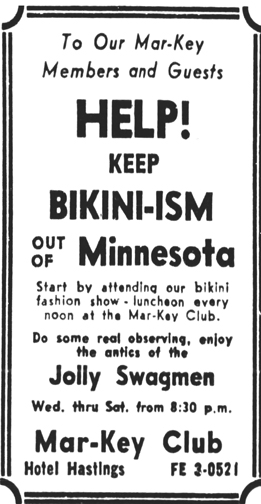
Minneapolis Tribune, January 22, 1965
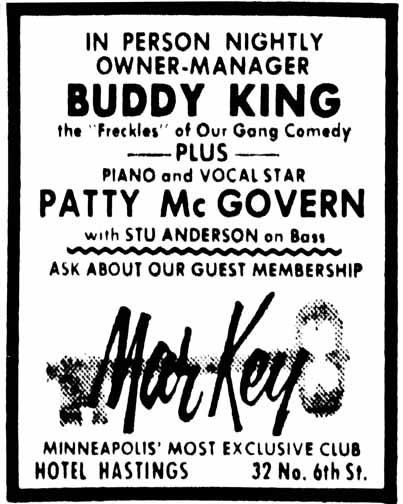
Minneapolis Star, July 19, 1967
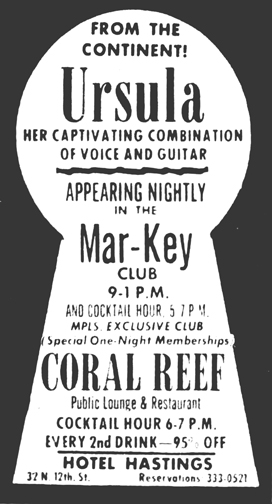
Minneapolis Star, September 15, 1967
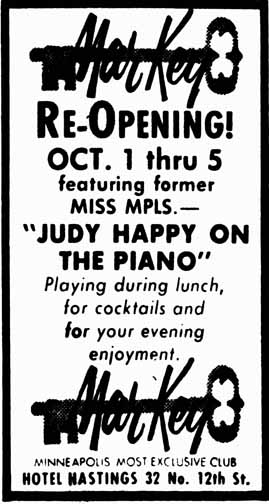
Minneapolis Star, October 2, 1968
In 1968 the Hotel started selling paintings.
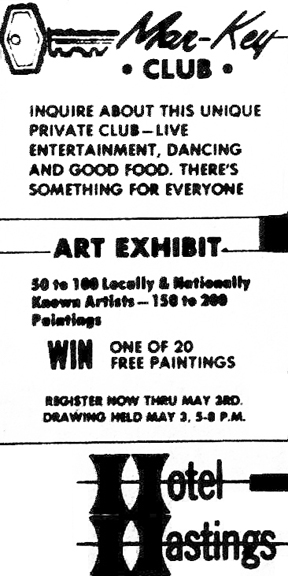
In January 1969, Danny’s Reasons began to perform at the Hotel, alternating with the Nite Caps, until April 1969.

Minneapolis Tribune, January 5, 1969
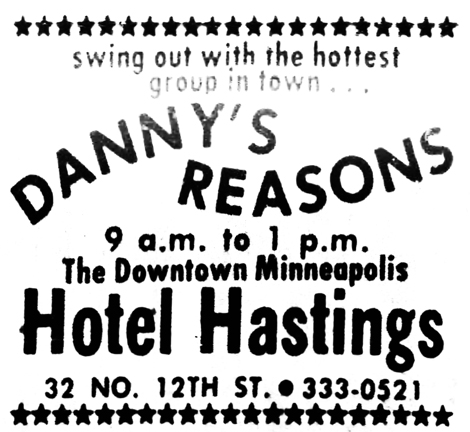
Minneapolis Star, January 8, 1969
CLOUD 9
This was a members-only discotheque in the hotel, mentioned in an article about fashion in the Minneapolis Star on July 7, 1964.
THE CORAL REEF LOUNGE
The Coral Reef Lounge was a public bar in the basement of the hotel. In its final years, the Coral Reef had two fires – one was started by a cigarette, and one was determined to be arson.

Minneapolis Star, August 23, 1967
In April 1969, the Coral Room was renamed Alley 12. In 1969 it featured Phillip LaMont. It was the liquor license of the Coral Reef that was transferred to the Depot in 1970.
HIGHWAY CONDEMNATION
In July 1969 the hotel started advertising the sale of its belongings because it had been condemned by the highway department, which took possession on September 11, 1969. Owner Jack Dow was paid $495,000 for the property. The building was demolished in November 1969 to make way for the westbound lanes of Highway 12 into downtown.
Dow offered the Coral Room’s liquor license to Danny Stevens, which he used to open the Depot. Dow planned to move the Mar-Key Club.
308 – 310 1/2 Marquette Ave., Minneapolis. Again, not sure if there was music, but here are two shots of a very cool ashtray from the collection of Mark Youngblood:
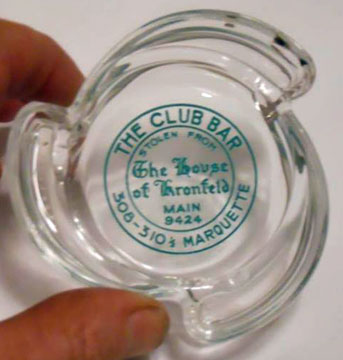
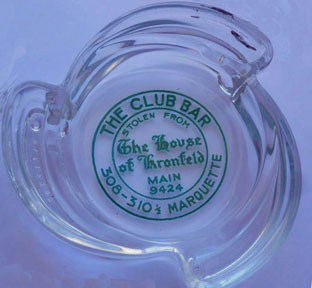
This branch of the Howard Johnson’s franchise was located at 7801 Normandale Blvd. in Bloomington.
It was opened in 1963, according to the kind source of the photo below, Gary Phillips. The daughter of the superintendent on the job says that it was built by Built by Rauenhorst Construction.
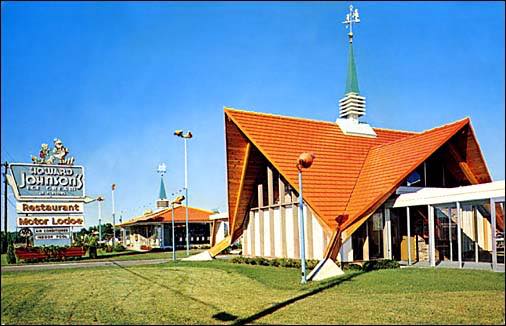
The lounge was called the Double Bubble Bar, and served a wicked drink with the same name. Nothing comes up in a search except gum and pick-up truck toppers, so we’ll have to take that as a Facebook fact. One would hope that there would at least be a piano in the place, but there’s no guarantee.
The property with that address in 2020 is apparently a closed Chili’s restaurant. Although easy to see from Highways 100 and 494, the interchange makes the location difficult to get to, which probably contributed to the motel’s demise.
Howard Wong’s Famous Chinese Restaurant was located at 2701 Southtown Drive (494 and Penn), in Bloomington.
The Dragon’s Head Lounge featured Don Taft nightly for your singing and listening entertainment from 1967 to 1970.
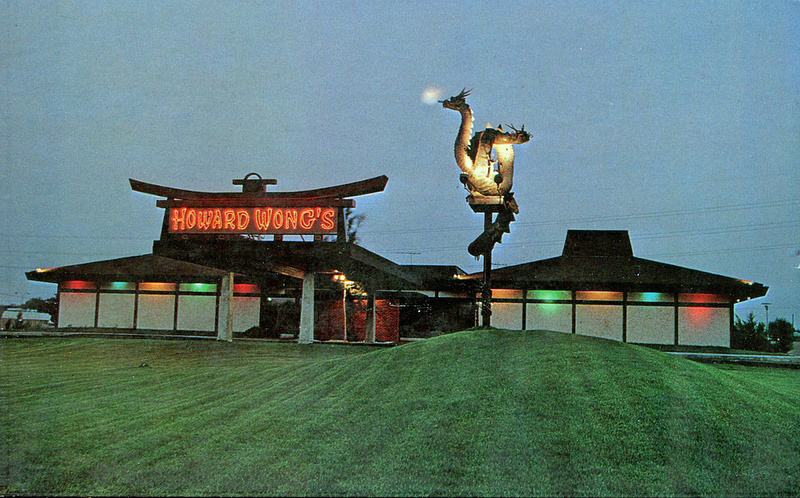
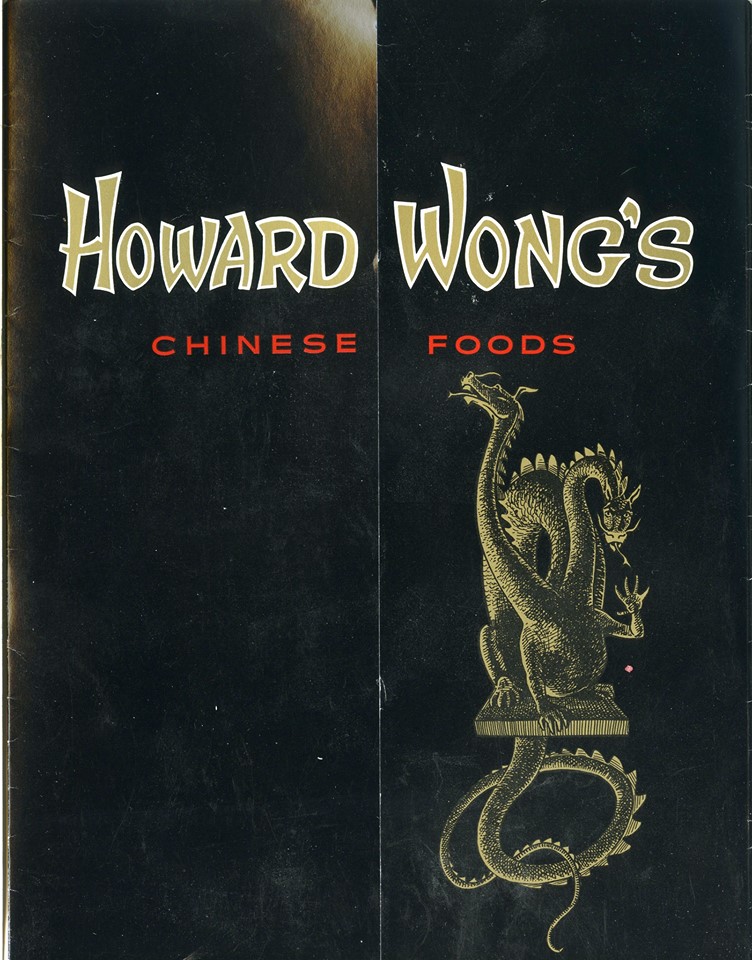
Menu from 1967
THE DRAGON
Wong’s was advertised as “Where you see the World’s only Twin Headed Flaming Dragon.”
According to the book Six Feet Under: A Graveyard Guide to Minnesota, the sculpture was created by MN artist Donald Danielson. The dragon breathed fire, propelled by gas, until the energy crisis of 1974.
When Howard Wong’s was sold, the Dragon was moved to Moorhead State University (now the University of Minnesota at Moorhead), where the team name is the Dragons.
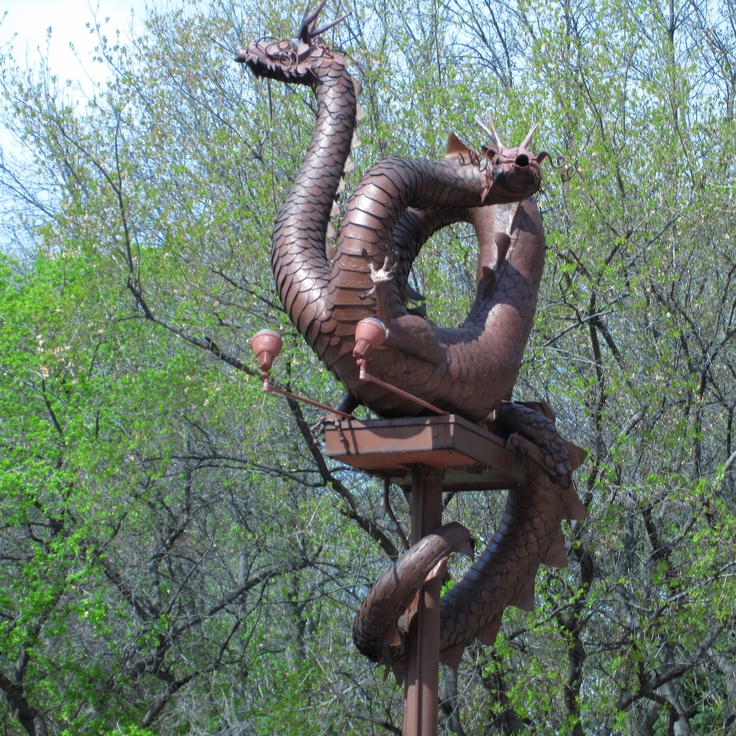
MANDARIN YEN
Howard Wong’s became the Mandarin Yen.
The bar was called the Ginseng.
Louis Lee ran a comedy club called Belly Laughs in the basement. Lee has been running Acme Comedy Club for many years. The club featured local comics Scott Hansen, Louie Anderson, and Wild Bill Bauer as headliners, among others. Future national comics also appeared there, such as Andrew Dice Clay, Dennis Miller, and Tom Arnold.
Alan Larson:
That building has been demolished for many years. Then the DC Hey Computer building when in . That was back in the nineties. Probably early nineties if I remember. About the time the putt putt golf course closed. And that little strip North of Target went in its place.
Howard’s Steak House was located at 715 Sixth Ave. No.
This was a famous jazz venue, home of after-hours jam sessions with Lester Young, the Pettifords, Duke Ellington, and Eli Rice. It went back to at least the spring of 1950.
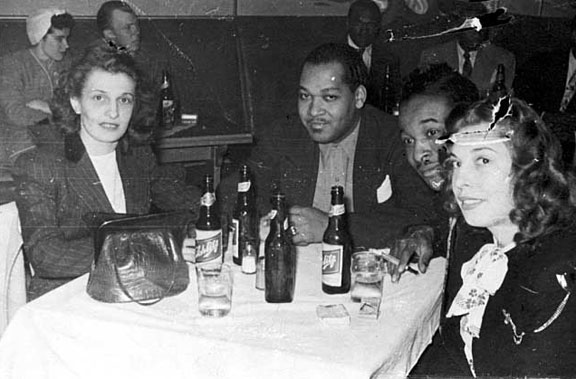
Ira and Jeanne Pettiford and Friends at Howard’s Steakhouse, 1950. Photo courtesy Minnesota Historical Society
HOWARD’S CLUB JAZZ
In September 1952 Howard’s Steak House became Howard’s Club Jazz. Performers included:
- Eddie Williams Combo – sax man supreme
- Stan Williams – percussion star on double drums
- Mr. X, vocalist and pianist
- B.B. King
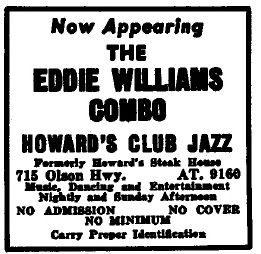
Minnesota Daily, October 1952. Ad courtesy Robb Henry
Howard’s Club Jazz advertised in the fall of 1953:
-
- Ira Pettiford and His All Stars
- Rook Ganz
- Frank Hines
- Perry Peoples (who perpetrated the fake Buddy Miles hoax in 1971)
On December 31, 1953, Howard’s Club Jazz reopened under new management.
In June 1954 it was back to Howard’s Steak House, with the Five Cats playing nightly.
It closed in 1955.
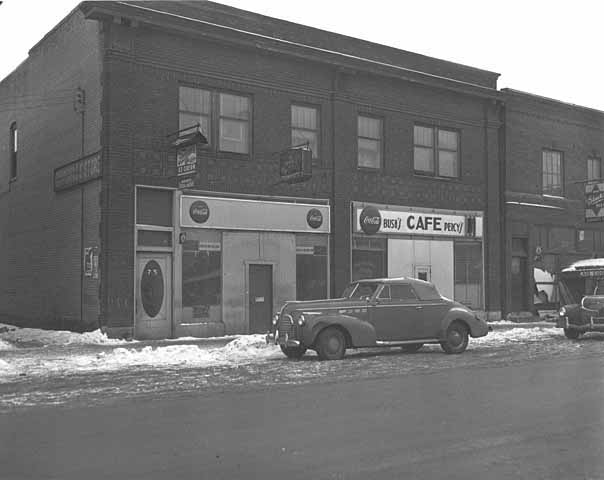
Howard’s Steak House. Photo courtesy Minnesota Historical Society
The building was demolished in about January 1957.
The Hub Bar was located at 224 Hennepin Ave., in the Gateway district of Minneapolis.
THE BUILDING
This tavern was located above the Little Holmes Hotel, 220-226 Hennepin Ave. From the 1870s the site was a ladies hat and clothing store, Williams’ Book Store, other clothing and grocery stores. In February 1931, Communist demonstrators wrecked and looted the Gateway Market. Their reasoning was that if a man was hungry, he had the right to obtain food any way he could.
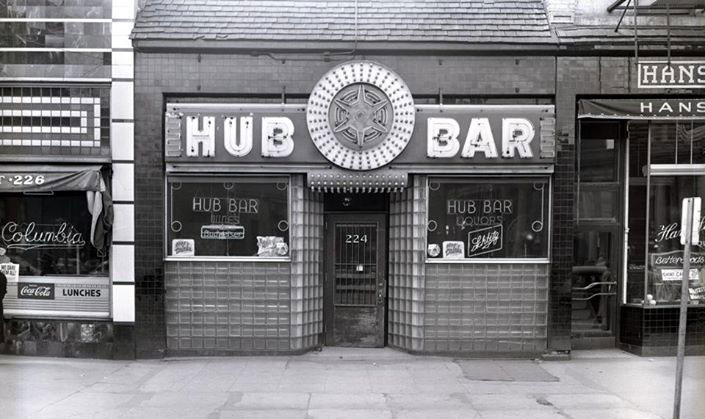
1943 Photo courtesy Minnesota Historical Society
THE HUB BAR
On September 28, 1934, soon after the end of Prohibition, the Hub Bar was created when an on-sale liquor license was issued to John V. Dougherty. Permit records show 2-3 Floors of the building were demolished in May 1934, but just at 224.
On February 7, 1935, an ad was placed for a young woman to play and sing in a tavern – preferably an Alto voice. (Minneapolis Tribune) Dougherty also received a Dance Hall permit in 1935.
On July 29, 1938, the business was incorporated as the Hub Bar, Inc. with John Dougherty as president. Other officers were Mrs. Mary E. Wright, secretary, and J.E. Wright, treasurer. In August 1938, John and Mary Dougherty transferred their liquor license to Hub Bar, Inc. Dougherty exited the Hub in 1939. (Minneapolis Tribune, August 13, 1949)
On August 30, 1940, an ad was placed in the Tribune for a “SNAPPY girl to play piano in tavern.”
The bar owners lost their license on March 29, 1940, on charges of maintaining gambling devices. A “14” and a Bing game had been found there on December 23, 1939, by self-appointed bar inspector Rev. Henry J. Solteau. (Minneapolis Star)
[In 1941 to 1967, the Silver Hub Bar was sited at 2500 24th Ave. So. in Minneapolis. ]
On November 12, 1941, Charles L. Clarity claimed that he had signed a partnership agreement with Mrs. Louis Banks to draw a salary to manage the club. In December 1945, Clarity had been locked out of the bar and sued the partners for back pay. The other partners were named as Mr. and Mrs. Louis Banks and Marty Joyce. (Minneapolis Star, December 7, 1945)
Mr. Louis Banks died in September 1949, and on October 1949 the City Council approved the transfer of the license from his widow to Morris Dworsky.
E.F. Dougherty was named as the manager in an article from March 1953.
As of February 1962, the Hub was one of only 11 bars left in the Gateway, which was being demolished for redevelopment. James S. Enger was the holder of the license at the time.
The building was demolished in November 1962, and an apartment complex was constructed on the site in 1965.

Please see Wonder Vue Cafe.
The building at 101-103 E. Hennepin housed:
- The Huddle Bar and Cafe
- Arturo’s
Early occupants of the building were:
1920: The East Hennepin Restaurant
1921: Minneapolis Brewing Co. advertised the second floor as a rooming house.
September 1934: Joe’s Bar
1936: Owner Max Gallus charged with maintaining a slot machine. Paid $25 fine.
December 1938: Joe Gallus’s Bar
December 1939: Joe Gallus’s Five and Dime Bar
THE HUDDLE BAR
The establishment had become the Huddle Bar by January 1, 1941.
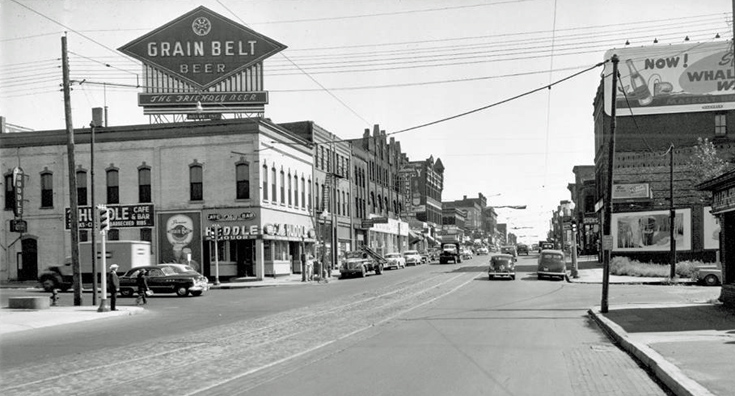
1949 photo courtesy Minnesota Historical Society
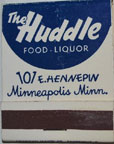
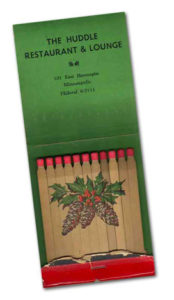
The following three photos are from the Minnesota Historical Society, all dated September 19, 1958. Don’t ask me why the gentlemen are mopping the floor in a suit and ties.
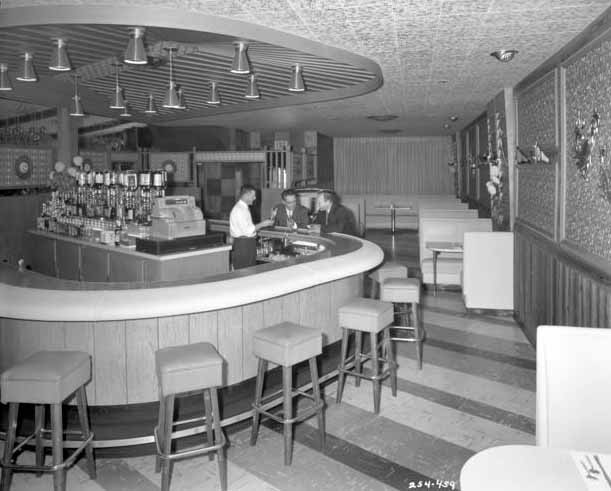
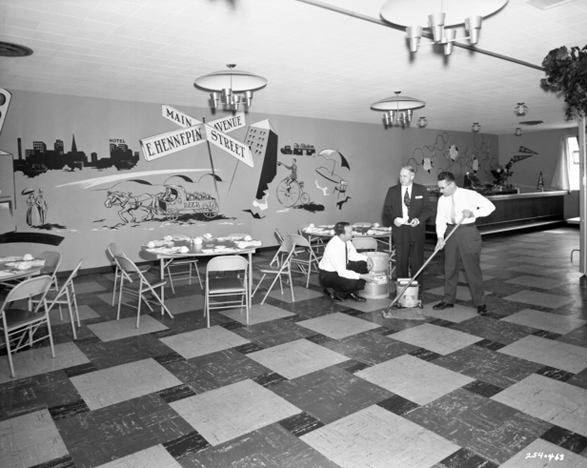
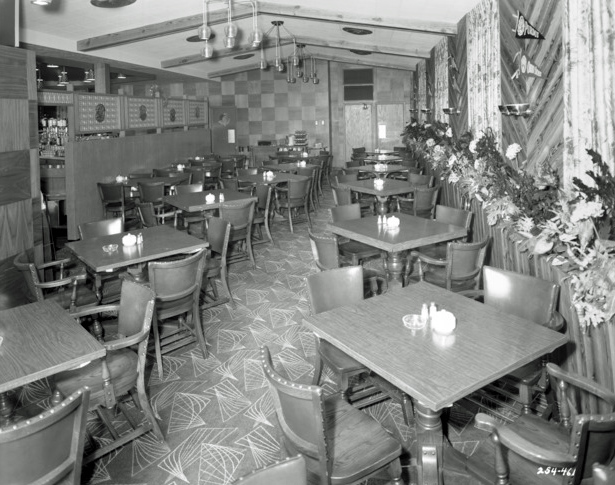
The Huddle was focused on football and organized buses to Gopher games.
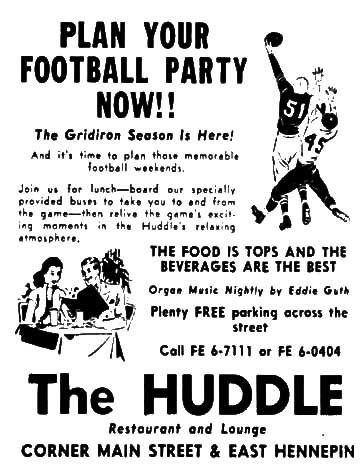
Minneapolis Star, September 3, 1959
In July 1961, brothers George and Clarence Brisky were in trouble for owning the Huddle and the Merchant’s Bar at 303 E. Hennepin. The City was cracking down on people owning more than one liquor license, and extended it to family members.
1963: Smooth Organ Music Nitely
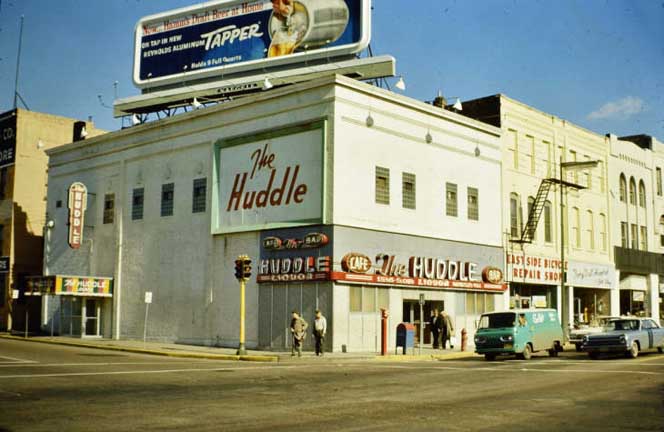
October 1965 photo courtesy Hennepin County Library
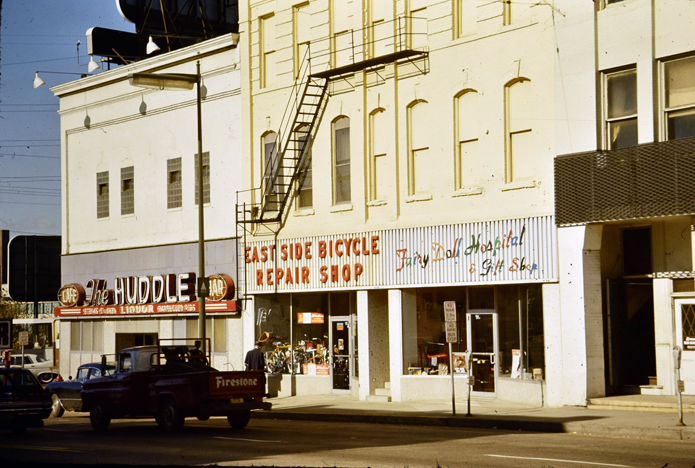
October 1965 Photo courtesy Hennepin County Library
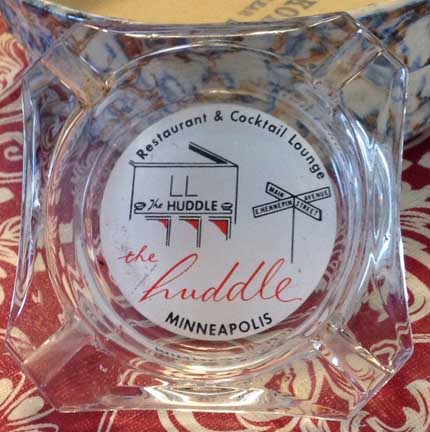
From the collection of Mark Youngblood
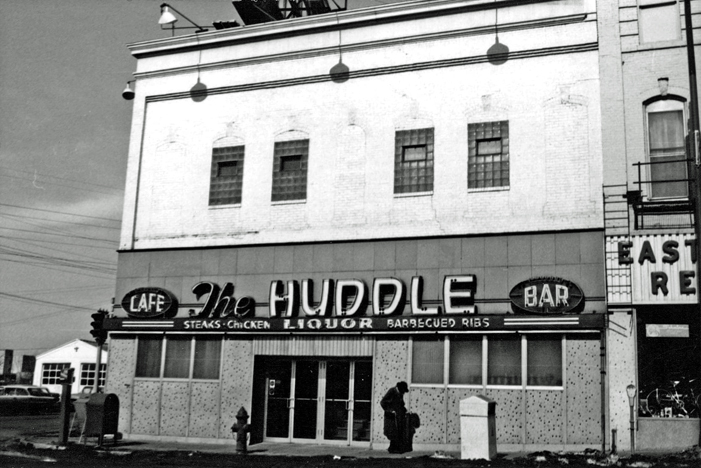
1967 Photo courtesy Hennepin County Library
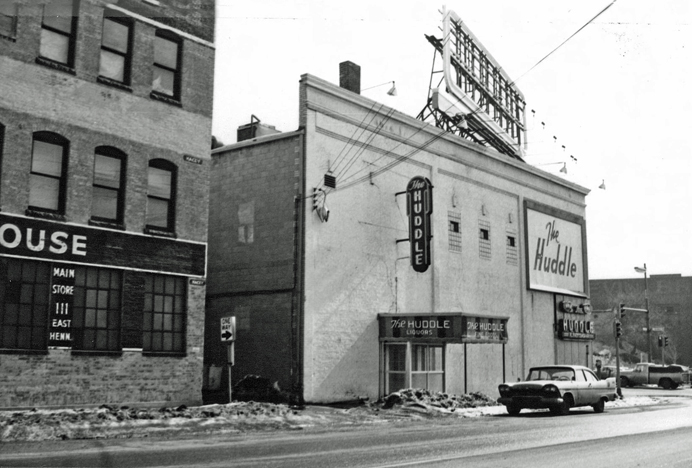
March 1967 photo courtesy Hennepin County Library
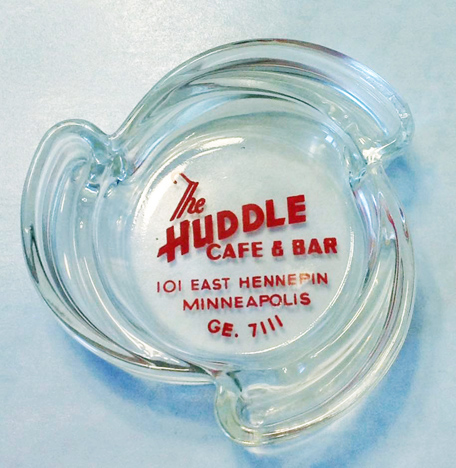
Another specimen from Mark Youngblood
ARTURO’S
In June 1971 the Huddle became Arturo’s, named, no doubt, for owner Arthur Mack. The manager was Steve Shattuck.
The upstairs party room turned into a rock club, featuring house band Allison-Bristow. Lori Fehrman was their “powerful girl singer,” according to Will Jones, and could be heard above the din. Downstairs was an Italian restaurant. (Minneapolis Tribune, June 6, 1971)
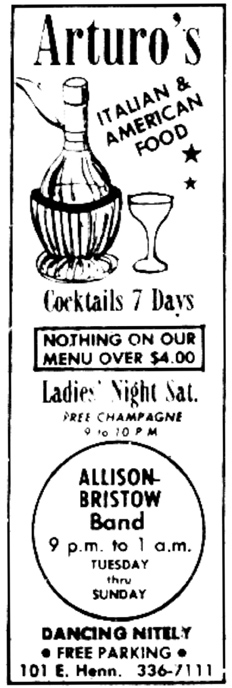
June 1971
On July 10, 1972, Kenneth Kronberg was fatally wounded in a fight at the tavern. In 1974 his widow sued the club for $250,000. The grand jury declined to indict the shooter.
Teen King and the Princes entertained at Arturo’s often. Other bands were Dakota, the St. Anthoni Band, and Brave New World.
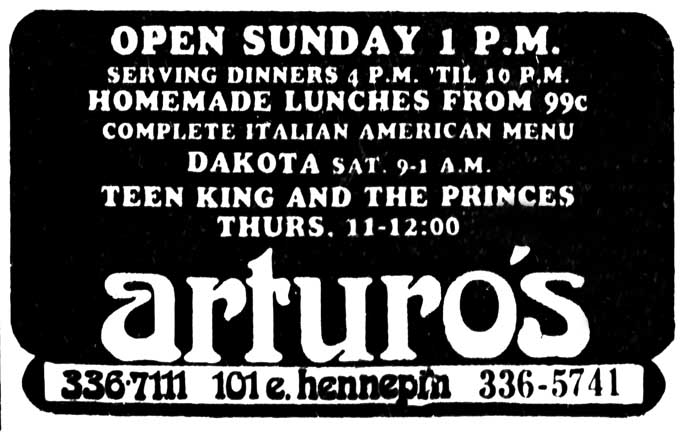
December 1972
On April 3, 1973, an ad was placed announcing that the club was closing due to the construction of a new bridge on East Hennepin. The club owners expected to open in a new location in a few months.
By July 1974, Arturo’s had lost its license.
The site appears to be part of Eastbridge Offices, built in 1984.
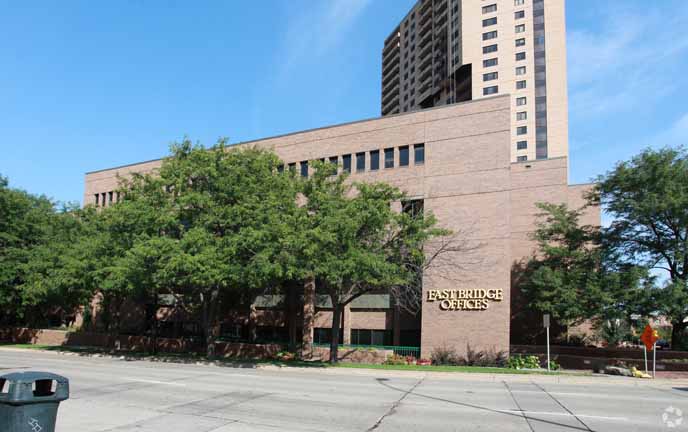
Save
The club officially called TV’s Hullabaloo Teen Scene, and then the Purple Cigar, was located at 6520 Cambridge Ave. in St. Louis Park.
PREQUEL
In October 1966, Park Music Center owners Morton Kaufman and Leo Fine proposed opening a club that would be open to kids aged 12 through 16. The two had just opened their store at 7200 Minnetonka Blvd. six months before, and were selling instruments to a lot of local bands. They were looking for more places for their customers to play. In the October 20, 1966, issue of the St. Louis Park Dispatch, Kaufman was quoted:
We’re thinking of a place where young people could meet their friends, listen to bands and have a hot dog and a coke. We would like to have the club open on Friday and Saturday evenings and Sunday afternoons. It is our feeling that youngsters in the lower teenage bracket need and want a place to go on weekends.
The club would charge annual membership dues and membership cards would be presented for admittance.
But the town fathers were quick to pooh pooh the idea. Mayor Kenneth Wolfe said,
There has been discussion of opening such clubs several times in the past. I think plans were abandoned mainly because when interested parties sat down to figure things out, they found that they could not come out financially. It seemed that minimal dues and the profit on cokes and hot dogs could not cover the costs.
City Manager Camille Andre joined in the naysaying:
There have been three applications to the council in the past six or seven years for ventures which might have been similar. All were turned won for one reason or another. The most recent application in 1964 was for a dance hall license for Lilac Way Shopping Center. We don’t know for sure that it was to be a teen club, but that was suggested by the fact that the application was for a place serving non-alcoholic beverages. The application was refused for insufficient parking and it was too close to an establishment selling intoxicating liquor which would make control difficult.
The Mayor said it might be a good idea IF the kids needed a place to go, but worried about “older, rougher young people trying to horn in.” The City Manager cited all the red tape that the club would have to go through.
The Dispatch solicited reactions to the plan from the schools and local clergy:
- Father O’Connor, Chaplain at Benilde: “I’m not in favor of it for that age children.” As soon as junior high students are mentioned in connection with such a club, I’m against it. I prefer to hold off individual boy-girl relationships and the night club atmosphere until they are older. If older boys and girls were involved, I would have no objection to the mixing of religious groups in such a social atmosphere.
- Howard Buska, principal of Central Junior High: “I think that something of this type which was properly supervised would be good for students, as long as it wasn’t taken over by cliques. I would have no objection so long as it didn’t interfere with our canteen attendance.” Central had two canteens each season for each grade on Friday evenings. He said that a teen club might be especially beneficial to kids who “Don’t have anything else to do — those who usually do not attend teenage affairs sponsored by churches, synagogues or other organizations. Supervision should be by parents along with off duty police, he suggested.
- Paul C. Schroeder, principal of Westwood Junior High, was definitely against the idea. “I think they are asking for trouble. Kids need to get together, but I think that junior high youngsters are too young for this type of arrangement. A club of this type might not hold the young people’s interest for long. Our school canteens are not always well attended. Kids get tired of doing the same things. I’m not sure how many parents would be in favor of a club.”
- Rabbi Moses Sachs of B’nai Abraham Synagogue said, “Such a program makes sense to me if developed within the scope of the proposed St. Louis Park Community Center with a proper building and proper group work supervision. Just providing a place is not enough. There are likely to be many problems unless handled by competent group workers.”
- Rev. Walter G. Johnson of Westwood Lutheran Church said he felt the idea would have merit if there were good supervision by a combination of youths and adults. “The adults should be ones with experience in working with youth.” He would object to supervision by the owners themselves. “With all due respect to their capabilities, such a place would require unbiased supervision. We are in need of a good wholesome meeting place for our youth in addition to those offered by the individual church or synagogue.” However, he would not be satisfied with a teen club where dancing was the only activity. “I think many of our 12- to 16-year olds are not yet at that social level. They would also want ping pong or some other activities.”
- Rev. John Foss of Peace Presbyterian Church said “There is a real need for this kind of neutral meeting ground for our young people of different faiths. A teen club such as the one proposed might serve a need for those who don’t fit into guided group activities.” He recommended “close supervision but not domination” by adults. “It sounds like an interesting proposition. I’ll be interested to see what develops.”
Editorial comment: What is this, the Sharks vs. the Jets in St. Louis Park? In 1966??
Upshot: Nothing happened
HULLABALOO TEEN SCENE
In 1967, Mrs. Barbara Jacoby of Wayzata asked the St. Louis Park City Council for a dance hall permit to operate a teenage night club. She said she held a $17,000 franchise from Teen Clubs International, and was negotiating a lease at 6520 Cambridge Ave. to open a club called “TV’s Hullabaloo Teen Scene,” one of 70 such clubs across the country. She said her goal was to be open on May 12, 1967. That date was pushed up to June 16 because a representative of the national franchiser, “Teen Clubs International, Inc.” was coming to town to help her set up the hall and establish policy. It eventually opened for the first time on June 22, 1967.
Her reasons for opening the dance club were quoted in the June 22, 1967, issue of the Minnetonka Herald:
I expect to offer teenagers fun place to go which should certainly meet with anyone’s approval that approves of dancing. I’m trying to give such a place to a group that needs adequate supervision but that doesn’t want to feel parents are breathing down their necks.
It was a tight vote – Councilman Frank Howard told her she would be blamed for every broken window in the area. Councilman Curtis Pearson said “I’m going to vote for the motion feeling like I’m playing Russian Roulette.” But the Park Council is always pretty ready to say yes, and on June 5 the permit was approved. Mrs. Jacoby was approved to operate on a month-to-month basis, each Tuesday, Thursday, Friday and Saturday night, at least through October. Ten off-duty SLP police officers were hired to keep order. Since the building was located in “Skunk Hollow,” an industrial park, there were no houses around and she promised that anyone down there would be in the hall and not in their cars.
Security was a big issue. In the same Minnetonka Herald issue, an editorial painted the picture:
..a dozen efforts to provide that kind of facility have ended in trouble in recent years. Always bands of young toughs (usually not ‘teens either) move in. Always there’s surreptitious drinking, by only a half dozen or so youngsters but just enough to cause trouble. Too often brawls ensue, neighbors and parents complain and the police move in.
Mrs. Jacoby was a High School Spanish teacher with three sons ages 20, 17, and 13. Michael Halleck remembers that he, Mrs. Jacoby’s son Fred, and Michael’s girlfriend Lonnie (now his wife) painted the inside purple. Lonnie went on to be a dancer – not in a cage, but on a box on the stage – complete with white vinyl Go-Go boots and a short skirt.
The club was to be for members only, with card holders allowed to enter for $1.50. The hall could accommodate 700 kids. On the first night, a Thursday, 600 kids came to check it out, but the next two nights saw only 200 each. Mrs. Jacoby said that she needed 300 on average each night to keep the doors open. Police reported no incidents over that first weekend.
The July 2, 1967 TMC Insider announced that “Bob Goffstein of Marsh Productions reports The Sparklers were voted by the Hullabaloo Scene as the Twin Cities most promising band, and that the group will act as a house band for the new St. Louis Park Club.” The Grasshoppers were also showcased.
The July 8, 1967, Minnetonka Herald reported:
[Mrs. Jacoby] hired as many as eight off-duty patrolmen each night to insure tranquility, but many teens said they were staying away just because of that.
An item in a local teen magazine reported that a new group called the Six Pack was performing at the Hullabaloo, and giving away six-packs.. of Coke.. during their show as a promotion.

Site of the Hullabaloo and Purple Cigar as it looked in 1960
The Monkees took over the KDWB airwaves for four hours on the day of their concert at the St. Paul Auditorium, August 4, 1967. During the show it was announced that on the following day, admission to the Hullabaloo Scene in St. Louis Park was only 97 cents (plus tax) – and an empty carton of Fresca.
There is an ad for the Teen Scene in the Robin Hood Days Program in August 1967. It was a teen dance (ages 16-20) was held at the “purple playground.” For $1.50 you could dance to the Stillroven, and free records were offered for “the first 200 swingers.”
J.C. PENNEY FASHION SHOW
On August 8, 1967, the “Hullabaloo Scene” was the site of Penney’s Rainbow Lane, a fashion show staged by J.C. Penney (known as Penney’s then), featuring clothing designed by Mary Quant, Victoire, and Ariel. There were five shows that afternoon. Rich Greiner was generous enough to share the following image of a Peter Max poster of the event, which is about 2 x 3 ft. in size.
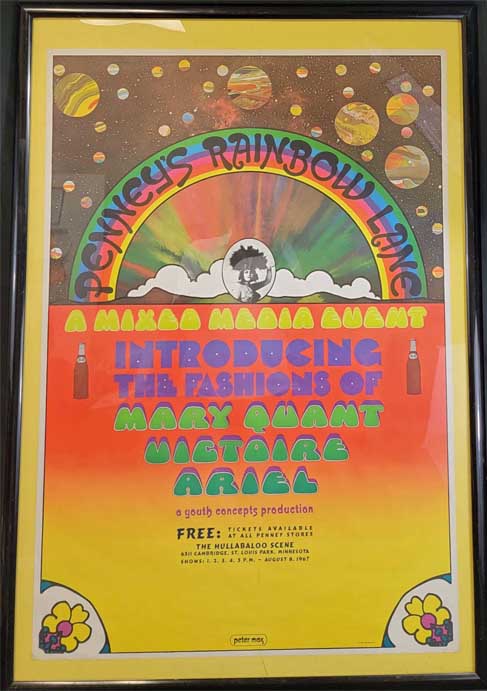
Poster image courtesy Rich Greiner
Denny Johnson of the Joker’s Wild still has contracts (booked by David Anthony Productions). They played the club on August 22, 1967 for $90. Mrs. Jacoby was listed as President, Park Teen Scene, Inc. Denny remembers that despite its grim exterior, it was a nice place with a soda bar and black lights.
The September 27, 1967 issue of the St. Louis Park High Echo had an article on this new hot spot for teens. Some excerpts:
Teen Club Has Purpose; ‘Hullaballoo’ Successful
Grey on the outside, it boasts only two small neon signs to mark its presence.
Inside are, in contrast, constant light, motion and sound. Flashing lights, rotating pinwheels, loud music and bodies in constant motion typify the inside of TV’s Hullabaloo Scene….
Mrs. Jacoby finally got the go ahead.. She feels that the club is gaining acceptance with the city council as a whole.
This acceptance Mrs. Jacoby attributes to the patrons themselves. She indicated that “the young people need and deserve a place that is clean and fun.
“They realize that this is their place, and that the future of the club depends on their actions.”
Mrs. Jacoby feels that an experimental club such as hers can benefit the community as a whole.
She pointed out that by initiating a club and showing that it is a workable arrangement, the door is opened for others to establish teen clubs.
This should eventually give teens enough places to go for entertainment that they won’t seek “less desirable places for their recreation.”
The dances are supervised by members of the St. Louis Park Police force. Mrs. Jacoby stated that “the same ones repeatedly volunteer for duty here, which is another indication that it is running smoothly.”
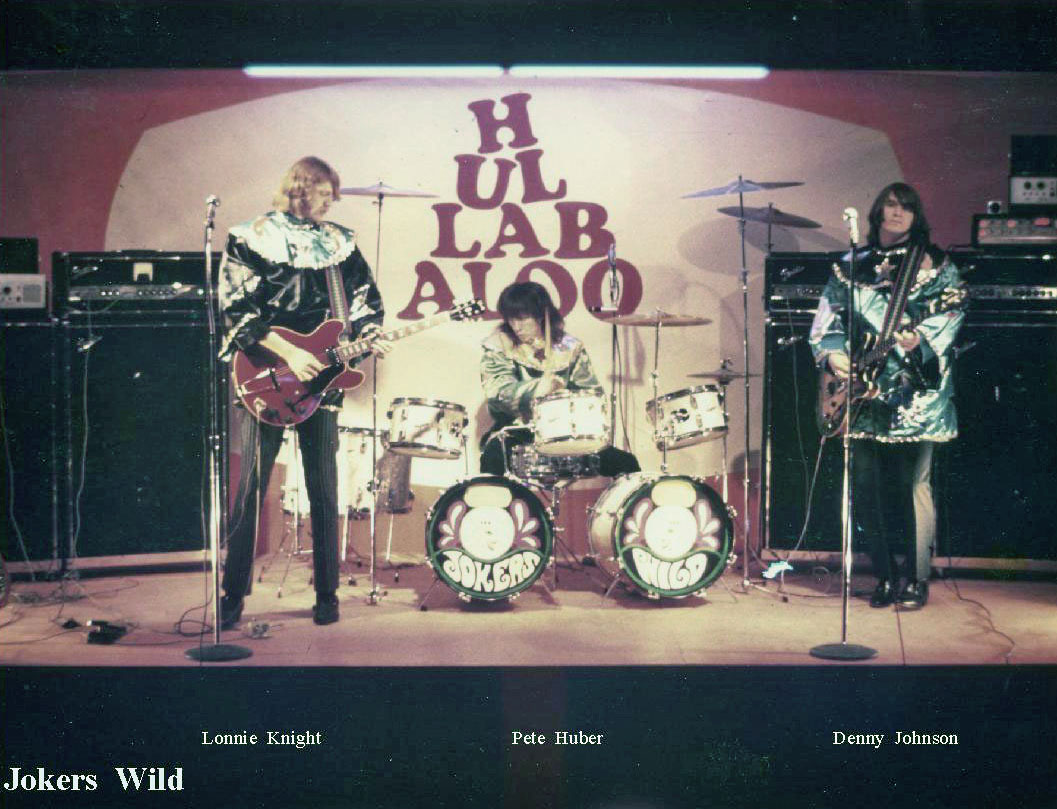
The Joker’s Wild played the Hullabaloo on August 22 and October 14, 1967. Photo courtesy Denny Johnson of www.Minniepaulmusic.com
I don’t know how long the Hullabaloo Teen Scene lasted. There is a small ad for it in the October 25, 1967 Echo. City council minutes don’t mention the place in 1968 except to say that Mrs. Jacoby owed them money.
NB: Morton Kaufman and Leo Fine, owners of Park Music Center at 7200 Minnetonka Blvd., voiced their disappointment that a permit was issued to an “outsider,” as they had tried without success to find a place to launch their own teen club.
THE PURPLE CIGAR
The Purple Cigar was listed at 6514 Cambridge in St. Louis Park in 1968. The club was owned by Arnie Sagarsky, hence the name.
Permission to hold “dances” had to be obtained from the City Council, which granted them on a month-to-month basis. Neighbors from along Cambridge came to protest. The first mention in the City Council minutes comes in January 1968. In March they were approved through June, but they had to have at least five Hennepin County Sheriffs on duty. Joker’s Wild played the Purple Cigar on March 29, 1968. Sagarsky was looking for an alternate site. Renewal of the permit may have been due to the testimony of Victor Olson, Youth Director of Westwood Hills Lutheran Church, who said that Sagarsky was doing a good job of operating the club.
In March 1968 there was a “misunderstanding,” as reported in the Insider, as the South 40, which used Vox equipment, was told that they needed to use the Del Counts’ Fender equipment because Sagarsky had an agreement with B Sharp Music owner Jim Lopes that only Fender could be used in the club. Connie Hechter, in his article in the Insider, was incensed at such an agreement, and said that it was against Union rules and club owners and bookers could not afford to make such demands.
From Johnny Canton:
Arnie Sagarsky asked Scott Burton and myself if we could obtain some record talent for a show at Purple Cigar. I came up with Strawberry Alarm Clock (“Incense & Peppermints”) and, if memory serves me, 5 Americans (“Western Union”). Even though it was heavily promoted on-air, the show bombed! Scott and I emceed.
From Ben Wilson:
The Purple Cigar and its predecessor were indeed located on Cambridge St. in a (then) white industrial-type building. If no one has yet written you about this, I’m surprised, as the places were packed. All the big local acts catering to teens played there, including St. Louis Park’s own High Spirits. The Litter used to smash their instruments at the end of each performance… I always thought they should just give them to me instead, and wondered how they made a living that way. Don’t recall how many nights a week they were open, but certainly Fri. and Sat. and maybe some weeknights, especially in summer. The kids were pretty well-behaved…don’t recall fights and the like. They may have come with a few beers in their bellies, but don’t recall dope-dealing, at least in ’67. Didn’t go there as often in ’68. Never had real good luck cruising the place, but the music was great and the club was well-attended.
I believe Mr. Sagarsky also ran the legendary teen club at 770 E. 7th St. in St. Paul, the name of which eludes me [the Cabaret?]. Or the SLP owner may have been his son. The older gent was a grandfatherly type, but one knew he must have been rather worldly to be running some of the hippest local venues of the time. Very friendly man, short and rotund, low-key but fearless.
Dave Weist remembered:
I lived very close to the club, just over the tracks and down two blocks to the west. The club was across the tracks from where Sam’s Club was located. There were a lot of local people that went to the club on weekends. Some of the bands that played there were Showtime Parts 1 and 2, Michael’s Mystics, The Litter and numerous other local bands. Our group Mike Fiedler, Barry Gilmer, Bob Laurus and I started a light show that The Litter used there. As a result we got to spend some time behind the scenes. Mrs. Jacoby was quite nice to us but you did not want to be overtly drunk or under the influence or she would have you arrested.
THE END OF THE CIGAR
Even though the Purple Cigar was located in an industrial area, there were still complaints from people living nearby. At the beginning of April 1968 an article in the Sun read:
No Buts…
Council Tells ‘Purple Cigar’ To Flick its Ashes Elsewhere
The Purple Cigar will emit its last puff of smoke in about 60 days but may rise from its own ashes in a new location shortly thereafter … Councilmen granted the teen night club’s owner Arnold Sagarsky licenses through the month of May, but made it overwhelmingly clear there would be no more permits issued for the club in its present location…. At hand Monday night were both proponents and opponents of the teen dance operation, as well as two separate trains of thought.
On one hand, some parents and community youth leaders argued there must be a place for St. Louis Park youth and, on the other, while most councilmen agreed with that thought, they felt the present location was definitely not the place.
“Should a dance hall be in an industrial area and should traffic have to come through a residential area?” asked Councilman Frank Howard.
“I wonder,” countered Councilman Richard Koch, “why we don’t apply the same standards to a number of on-sale liquor establishments on Excelsior Boulevard? Isn’t that a bit discriminatory?”
“I agree,” answered Howard. “But let’s talk about that when liquor licenses come up.”
The Rev. Douglas Norris, social pastor at Aldersgate Methodist Church, told the council, “I’ve been down there twice and I consider it a very well-run operation. The control I saw there was beautiful. We don’t have that good control at a church dance.”
Rev. Norris said that litter is also a problem at church dances, including the usual number of beer cans but, he added, “Of course they weren’t from our kids.”
He also said while he wasn’t an authority on zoning practices and the like, he felt a larger issue was at stake. “Maybe we should pass an ordinance not to have kids,” he said.
Earlier, Sagarsky told the council how he attempted to comply with earlier requests by hiring off-duty Hennepin County Deputy Sheriffs and directing exiting traffic through the industrial area rather than back through a nearby residential street. He also presented a petition signed by some area residents, stating they had no objections to such an operation. The petition was circulated, he said, by two teenage employees.
However, some area residents were still at hand protesting the club’s operation. James Manzer, 5718 Cambridge St., related how trash has been much heavier in his area since the club began and there have been instances of vandalism and tire slashing much more frequently of late. He also said the petition Sagarsky presented wasn’t fair because most residents who had signed lived on W. 39th Street which is a dead end; therefore residents get little or no activity from the “Purple Cigar.”
The motion to approve licenses for the next 60 days was approved 5-2… implicit in the motion was the sentiment that Sagarsky find a new location and, while at the present spot, keep the same level of control in force. Sagarsky, after the meeting, indicated he would seek a new location.
An article in the St. Louis Park Sun dated June 6, 1968, indicated that Sagarsky had been given until July 1 to relocate “because of some neighbors’ complaints and what council members considered problems with the location.” He was reportedly looking at three alternate sites within the city, and in the meantime, “business has been very good.” He also asserted that “Parents who have visited the club think our present location is fantastic, and that there is a definite need for a club of our type.”
In defense of the Cigar, Hopkins sophomore Bea Stull wrote an essay for her English class that her teacher forwarded to the St. Louis Park Sun. It was published as “An Opinion Special” on June 13, 1968. This is the best description I’ve ever seen of a 1960s teen club, and I will quote it in its entirety:
I feel that Mr. Sagarsky’s operation of the Purple Cigar … is one of the best places teens can attend. There has been no rowdiness there as has been reported at other places where teens can dance.
The teens there are all quite friendly. You don’t have to stand around very long to get asked to dance, as is often the case at school or church dances. Most of the kids I know agree that you dance most of the dances at the Cigar whereas at school and church dances you’re lucky if you get asked to dance five times, unless you’re there with a date. Even though the price is one and half to two times what you pay at school dances, it is well worth the extra 50 or 75 cents.
I would like to tell you what you would expect to find if you attended a dance at the Purple Cigar.
Once inside the door your identification is checked, usually by Mr. Sagarsky himself. Then, taking about five steps, you will find to the left the ticket booth. At the end of the 20 foot hall your ticket is taken and you enter the area where you can check your coat in, and if you’re a girl, your purse also.
ACCUSTOMED
By now you have become fairly accustomed to the noise. If you’ve come early or on time, the band will be tuning and teens will be talking. If you’ve come after the dance has started the band will be playing. As you step around the partition and onto the main dance floor the band and teens all come in sight.
In the beginning of the evening you notice how slippery the floor is, as if you are on ice skates for the first time.
The Purple Cigar is well cared for and is a pleasant as well as fun place to be. In the back of the room are some ultraviolet lights, below which is a snack bar. On the fence in front of the snack bar is usually sitting a row of teens. If you are wearing anything white you will notice it glow an eerie violet because of the ultraviolet lights.
At the front of the dance floor is the stage on which the bands play. When you go to the Purple Cigar, you can be almost sure of hearing a good band. Some of them are ‘Michael’s Mystics,” “The Metropolitan Soul,” “The South 40,” “The Underbeats,” “T.C. Atlantic,” and “The Litter.” These are all well known local groups.
GET SOME POP
If you get tired of dancing you can always go to the back and get some pop. There are many small round tables around which you can sit while you drink pop and talk to friend. You can also have as many peanuts as you want free.
Or if you want to, you can go beyond the snack bar and into a back room, which is called “The Peanut Room.” While here you can still drink pop and talk to friends, but at the same time you can watch old movies such as “Laurel and Hardy.”
Later on in the evening you’ll probably notice your shoes are sticking to the floor, one sign that the evening is wearing on. Another sign of this is the fact that the heat is so extreme. Even in the winter you begin to feel hot enough to be lying on the beach under the hot sun in the middle of July. Everyone dancing so much and having such a good time really raises the temperature of the place.
In the end you collect your coat and walk out into the fresh air. It hits your face very coolly, but you still wish the evening wasn’t over, even if it is so hot, and you can’t wait for the next time you can come back.
This, I think, is the way most teens feel about the Purple Cigar. It’s a great place to be and it should be allowed to stay as it is.
The Insider reported that the Purple Cigar was shut down by the city council because of disturbances.
IN MY OPINION…
Okay, I was only 8 years old and I wasn’t there, but I do know that the Hullabaloo/Purple Cigar was located in an industrial park called Skunk Hollow, surrounded by warehouses and machine shops. It is difficult to understand how “neighbors” could object to this place, especially since it was a teen club and probably closed early. Shame on St. Louis Park for shutting down what sounds like such a fun place!
These clubs were franchises, and there was another Hullabaloo Teen Scene in Fridley – please see Casino Royale for details on that club.
Save
Save
Save
The Spot, “located somewhere on 8th Ave. No.” was run by Ben Wilson, who left town in the late ’40s.
The Spot, Central Ave. NE and Highway 5 in 1932. Formerly States Inn. Dancing and Entertaining Every Night Featuring Al Foster. ” +WHAT A SPOT+ ”
There is another bar called The Spot on the corner of Randolph and Victoria in St. Paul, “Est. 1885.” Doesn’t sound like a music spot judging from the comments on the Old St. Paul Facebook page.
Ichabod’s Wet Goods was located at 52 So. 7th Street in Downtown Minneapolis. The building dated to 1893. It opened in November 1972.
The building was formerly the home of:
- The Golden Pheasant Inn December 1920 to September 1926
- A.G. Spalding Co. March 1928 to December 1935
- Linpark Clothing March 1939 to April 1959
- Meyers Inn October 1960
- Running Fox March 13, 1962 to December 1965.
- Meyers got it back in December 1965 to April 1969.
The building was demolished in October 1979.
Ichabod’s was decorated with pictures of Minneapolis scenes of 60 years before.
Seems to have disappeared
Downstairs was the Boiler Room Bar and game room.
Please see the Gay ’90s, Downtown Minneapolis.
Technically, this was W.R. Frank’s Inferno, located at the Tremont Plaza Motor Hotel at 517 Excelsior Blvd. (now Mainstreet) in Hopkins.
The Tremont was built in 1960.
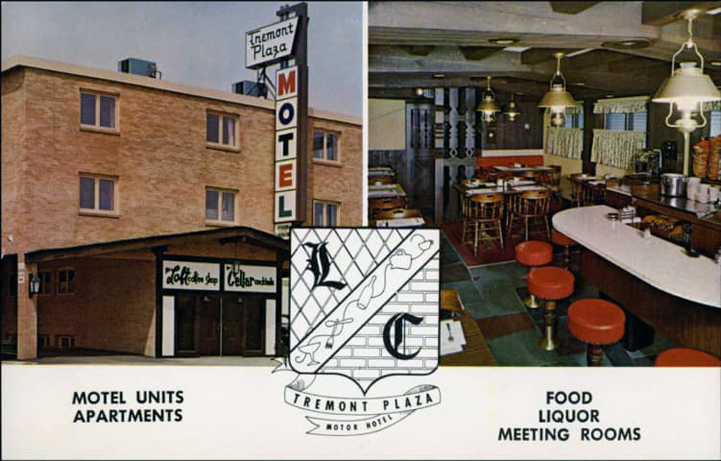
Postcard image courtesy Hennepin County Library, per James Kenline
From the ad below it appears that the nightclub, formerly called the Cellar, opened on February 25, 1972.
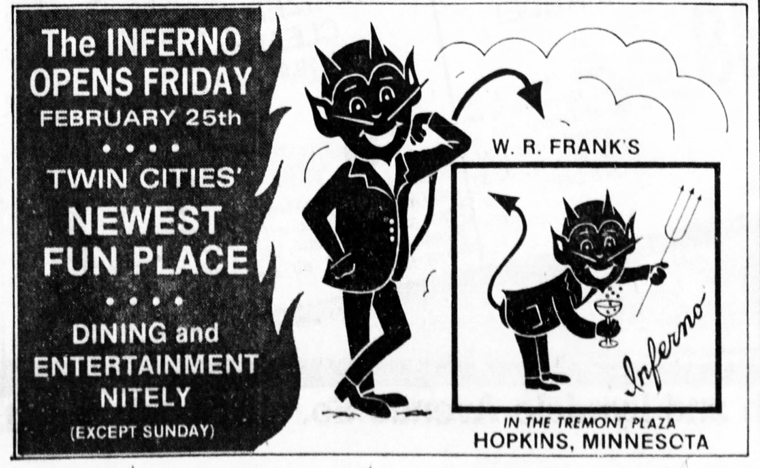
Minneapolis Tribune, February 1972
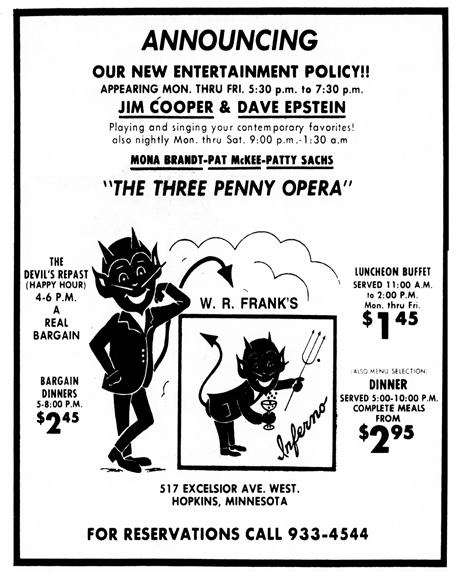
Minneapolis Tribune, August 1972
It is now called the Hopkins Park Plaza Apartments and rents out fully-furnished apartments.
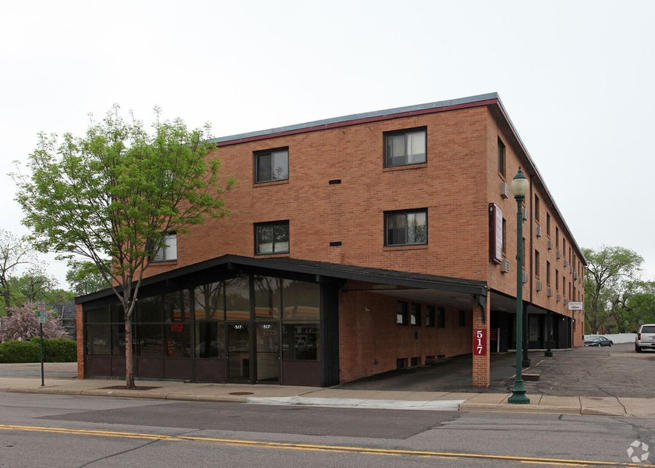
A more recent view of the building.
4410 – 10th Street No., Minneapolis. July 1963, per the Twin Citian: “Dan Lee, organist and pianist, appearing in the Hubcap Bar amidst an atmosphere of antique automobile accessories.” Cool.
Please see Club 65.
There were several music venues located at 5630-36 Lakeland Ave. in Crystal.
- Scandia Supper Club: October 9, 1961 to May 1964
- Crystal Coach: April 1966 to March 1969
- Rusty Nail: March 1969 to 1997
- Iron Horse: July 1977 to January 25-26, 1997
SCANDIA SUPPER CLUB
Leonard Nordquist built the building in 1961. By 1962 he had run out of money and was selling an interest in the business in order to raise the capital needed to complete the piano room, etc. The building had two stories.
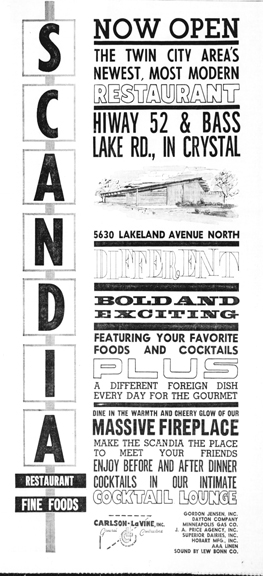
October 22, 1961
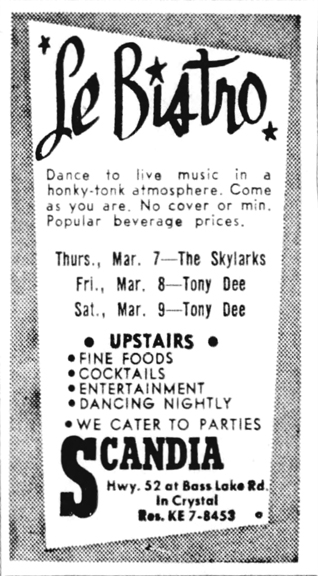
March 7, 1963
THE CRYSTAL COACH
The Crystal Coach was owned by Bob Stein of Winona. It opened to the sounds of Irv Williams and his combo, 7 nights a week. In 1967 you could dance nightly to the Mel Calvert Trio.
Hmmm….. The Mann Act is a law that puts a man in Federal Prison if he transports an underage girl across state lines for nefarious purposes. The name of this duo probably wouldn’t fly today!
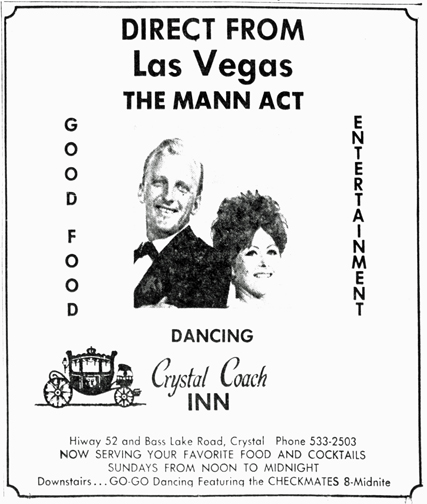
December 24, 1967
There was also Go-Go dancing downstairs, featuring the Checkmates.
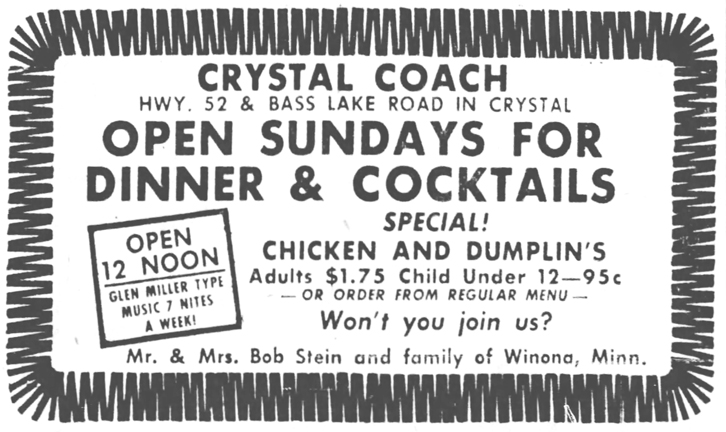
October 13, 1968
RUSTY NAIL
The Rusty Nail was owned by Virgil Miller. Miller was remodeling in March 1969.

March 21, 1969
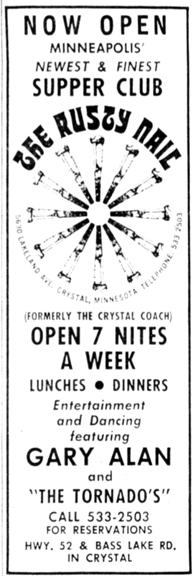
June 20, 1969
In 1970 the Main Lounge featured the Riverboat Ramblers, and the Lower Lounge featured the more outa sight sounding Sea of Tranquility.
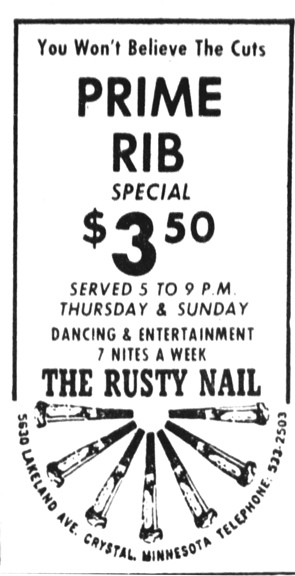
February 10, 1972
IRON HORSE
Virgil Miller sold the club to Phil Eder in January 1977. The Iron Horse opened in July 1977.
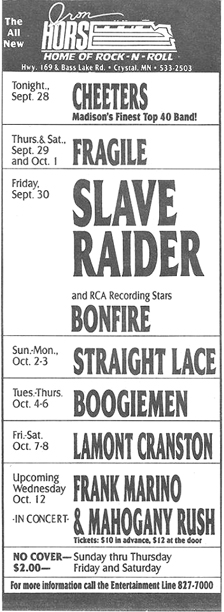
1977
Michael J. Paepke offers this memory of the Iron Horse:
Two unforgettable performances come to mind: “Frank Marino & Mahogany Rush,” where I stood right in front of his mic stand the entire show watching his hands, and the “Pat Travers Band,” kickin’ my ass playing every one of his hits! Great venue to see live music, excellent sound, tons of memories! I really miss the EMBER’S restaurant right down the street where all the bands used to hang after their shows – tons of hair-spray, leather and denim!
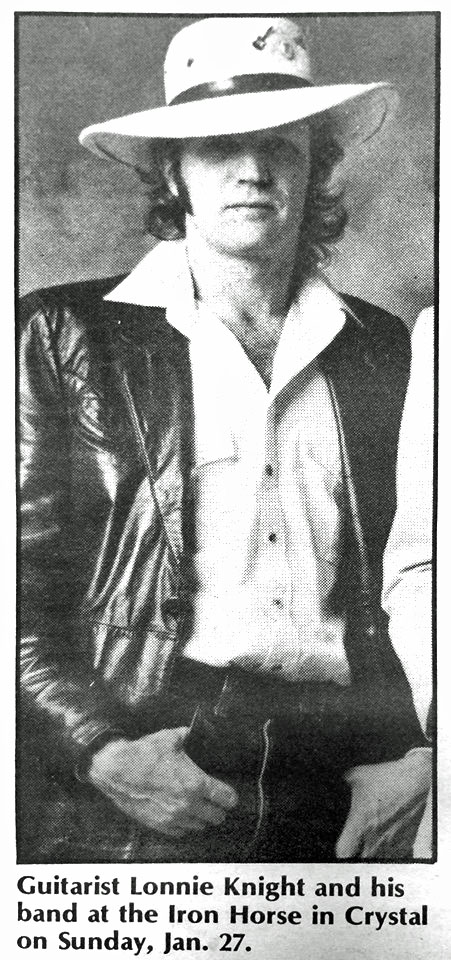
Photo of a very foxy Lonnie Knight posted by Robert Burtis.
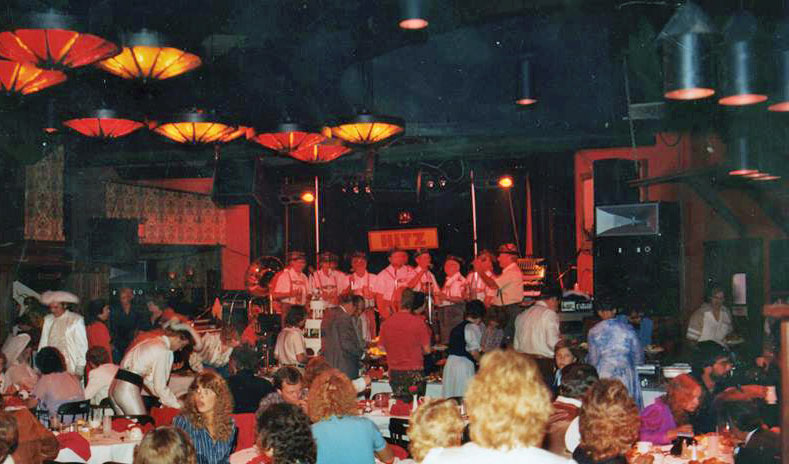
The view inside the Iron Horse in 1982, also courtesy Robert Burtis
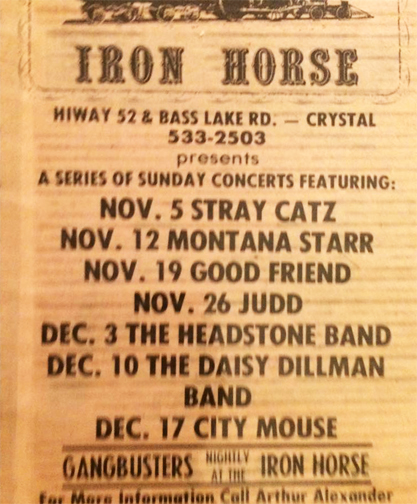
Flier courtesy Sandra Kenyon
The Iron Horse became famous for its noontime lingerie shows where scantily clad models entertained. Jesse Ventura briefly worked at a bouncer there.
The last musical genre presented at the Iron Horse was Heavy Metal Hair Bands. Its demise over the weekend of January 25, 1997, was reported in the Strib by Jim Meyer (January 24, 1997).
The building apparently ceased to be a music venue when the Iron Horse closed.
The Island Plaza Bar was located on Highway 10 (back then), in St. Paul Park. It was on the east side of the Mississippi River, just across from Inver Grove Heights. A junk yard was located just behind it.
The building had gone through a number of names, according to my informant, Buzz Bauman:
It was originally a gun club.
Then in the late 1950s and early ’60s it was a roadhouse called Park Plaza that had country music – rumor has it Johnny Cash played there before he hit it big.
Then it was Kelly’s Park Plaza (which was supposedly busted for having strippers!).
Bud and Igor’s
After that was the Three Stooges Lounge, but they defaulted and it went back to being Bud and Igor’s, who tried to run it as a polka bar.
Finally it was the Island Plaza, owned by Dana Isaacs from the fall of 1975 to August 1977. The name was chosen because the property was partially located in Grey Cloud Island township.

Image courtesy Buzz Bauman
It was a rowdy, backwoods bar that hosted bands such as:
- Lamont Cranston Cranston
- Willie & the Bees
- Skogie & the Flaming Pachucos (their favorite band)
- Berlin
- Magnum
- Trick
- Chameleon
- Mojo Buford
- Visage
- Bush Lake Road
- Stone Broke
- Jet Jackson
- Obsession
- Free Ticket
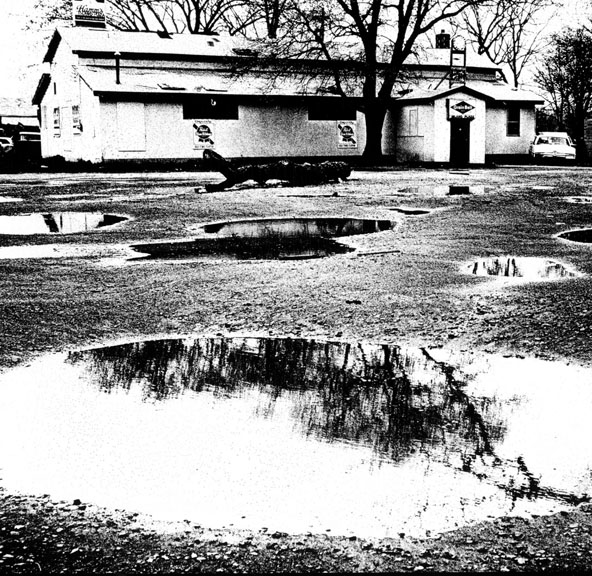
Photo courtesy Buzz Bauman
Last anyone knew, the parking lot was filled with junk cars, and carburetors were piled high on the bar.
Jack’s Chicken Shack was located on the northeast corner of Walnut and West 7th in St. Paul.
MOBBED UP?
From Placeography:
Jack’s was a hangout for the city’s small-time gangsters. One of them, Tony DeVito, was last seen at Jack’s sometime in September of 1953. His body was never found. A local gangster was a suspect in DeVito’s murder. The owner of Jack’s was called as a witness, but spent time in prison for contempt of court. When he returned in 1961, he disappeared from his restaurant. His body was later found, but no arrest was ever made.
THE JONES BOYS
It wasn’t all mayhem and murder, though. I received an email from Bob Wiese who remembered playing in a band called the Jones Boys on Friday and Saturday nights there in 1963 – 1964.
Bob says:
The band members were: Al Lloyd, drummer, Russ Miller, bass and vocals, Lee Hart, rhythm guitar, and I, Bob Wiese, lead guitarist.
Do you know of anyone who might have taken pictures of our band during our playing days there? I don’t have any and would like to contact someone who may have followed our band and maybe took pictures of us. I just want them for memories of the good times we had playing there. I would compensate anyone who could find any for me – even the outside of the bar, would be great! Anything I can find from those days would be exciting.
If anyone has pictures or memories of Jack’s Chicken Shack, please contact me! Thanks!
Jack’s Place had a rather strange ad in the Republican Register from July 1943 to August 1944. It was only identified as being in Bloomington, offered Refreshments – Music- Dancing, and promised to be “A Clean Place to Go.”
Okay, this is the story of 1706 Fourth Ave. So., but don’t go looking for it, because you will be in the middle in the interchange of Interstates 94 and 35W. This building was torn down in 1956. But there was fun to be had along the way.
Now this is a bit confusing, so first let’s get our numbers straight. Sometimes the newspapers weren’t very accurate, and some City permit cards are overlapping or missing, so I’m kind of doing this by the seat of my pants.
1706 was a one-story building, constructed in 1911 with the dimensions 28′ x 127′ x 14′.
1708 was a two-story building, constructed in 1903, 22′ x 58′, with stores below and apartments above.
The narrative below is about 1706 unless otherwise mentioned.
GOPHER THEATER
This building at 1706 Fourth Ave. So. was built as a theater – the Gopher Theater, to be exact, and the first Gopher Theater, to be more precise. It appears to have been the Gopher Theater until about 1921. A new Gopher Theater took its place in about 1925.
THE MATTHEWS TAVERN
The paper says Tom Matthews established a restaurant at 1708 Fourth Ave. So. in April 1932. But was he really at 1708 or was he in 1706? It seems pretty clear that when Prohibition lifted, Tom Matthews established a tavern in the old theater at 1706.
An ad in the Minneapolis Spokesman, the City’s African-American newspaper, announced the Town Talk Dance, the Second Annual Breakfast Dance given by Ray Dysart and his K.C. Rhythm Kings on Christmas Morning, December 25, 1934. The hours were from 3 am to 7 am! The ad exclaimed, “Best Band… Best Dance Floor… Something New and Entirely Different. Cabaret Style. Admission 35 cents. The Matthews Tavern was at this location until at least February 1935, according to an account of a foiled stick-up.
THE JAIL HOUSE
By September 1935, Tom had changed the name to the snappier Matthews Jail House, again featuring Ray Dysart and his Six Rainbow Rhythm Kings.
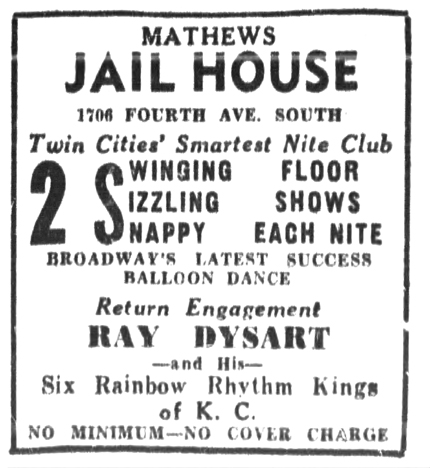
Minneapolis Tribune, September 28, 1935
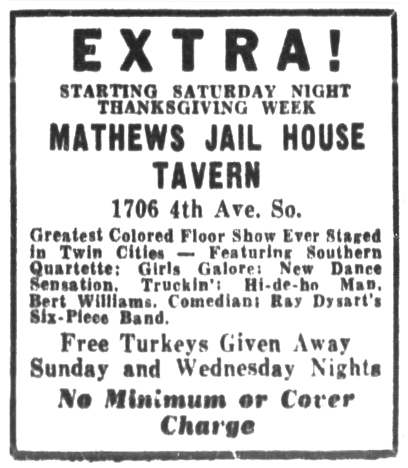
Minneapolis Tribune, November 23, 1935
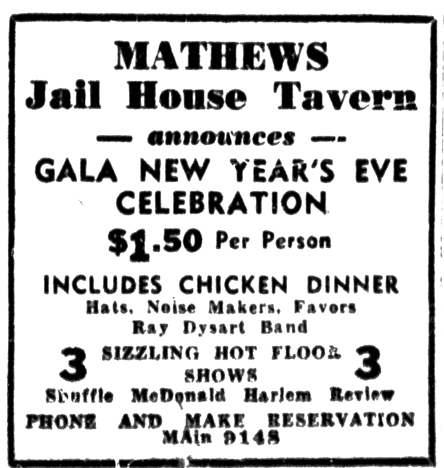
Minneapolis Tribune, December 31, 1935
In a wee bit of irony, William J. Smith was given 20 days in the workhouse for selling liquor without a license at the Jail House in January 1936.
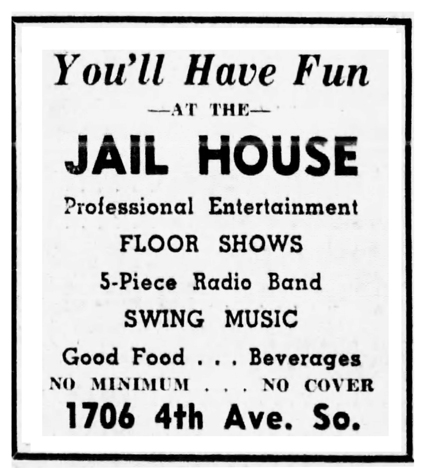
Minneapolis Star, August 21, 1936
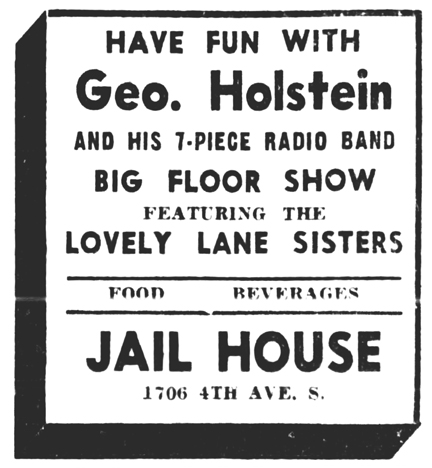
Minneapolis Star, October 16, 1936
The last mention of the Jail House seems to be in December 1936, when the place was advertising for amateurs – kind of the death knell of a night club.
THE BRIG
In April 1937, Louis Banks was awarded a liquor license at 1706 for a place apparently called The Brig. Last seen in November 1937. Impossible to search for The Brig – too many Generals!
BAKERY
By January 1941, 1706 had become the home of the Treasure Baking Co., which it would remain until about 1947.
In October 1948 it was the treasure of the Home Bakery, which proceeded to burn the building down. On October 20, 1948, there was a two- alarm blaze, fed by lard, wax paper, and all manner of flammable baking paraphernalia, that took three hours and 12 pieces of equipment to douse. The paper’s account described the building as a one-story brick affair, measuring 80′ by 40′. This is entirely inconsistent with the dimensions given when the original theater was built. (Minneapolis Star, October 20, 1948)
The Bakery was up and running again, until at least May 1949, but its assets were being auctioned off in September 1951.
In September 1952 an opening was cut between 1706 and 1708 (I think) to accommodate the Lorenz Furniture Co.
DEMOLITION
There was another fire on January 1, 1956. Our old Jail House didn’t make it; 1706 was demolished in May 1956, and this time the dimensions matched those of the original construction:
1708 went on for another 16 years, but succumbed to freeway construction in December 1972.
The Jazz Lab was one of the first coffeehouses in the Twin Cities, located on the first floor of a duplex at 815 Payne Ave. in St. Paul.
It was a restaurant purchased by Dick Guindon and a partner in 1955 or 1956. Guindon, who became an iconic Minneapolis Tribune cartoonist, said, “We didn’t want to be restaurateurs, but we bought it to keep the hangout open.” The place accommodated 30 to 40 people, the tables sported checkered tablecloths and candles, and the menu consisted of ready-made pizza, sandwiches, and “after dinner” coffee.
The walls were black, which Guindon said was a common practice among hip people in those days. News reporters came looking for beatniks, but Guindon said there weren’t any. The St. Paul came for a raid, only to find a discussion of the Great Books Club.
Musically, it doesn’t appear there were live performances, but it had a jazz jukebox, which was a rarity in the Twin Cities. It was open from 6 pm “to whenever,” and frequented by musicians, journalists, and “people who stared stonily into space,” as Guindon remembered it.
Guindon and his partner closed the Jazz Lab in 1958 when the upstairs tenant, a jazz musician, was busted on a pot charge.
This entire page is taken from an article about Coffeehouses by Jon Bream, Minneapolis Star, December 16, 1975.
owned by Steve Kimmell, opened July 6, 1973
Minneapolis
449 N. Snelling in St. Paul, offered dancing in 1943. This wonderful artifact below was posted on Facebook!
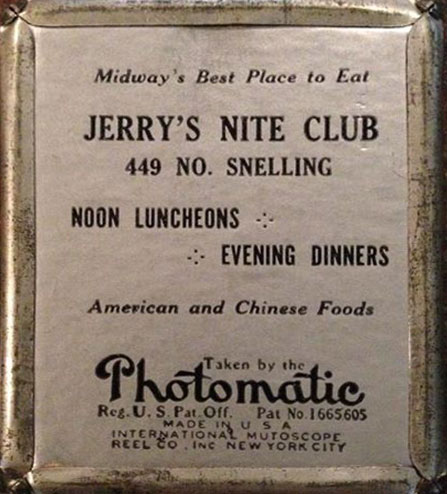
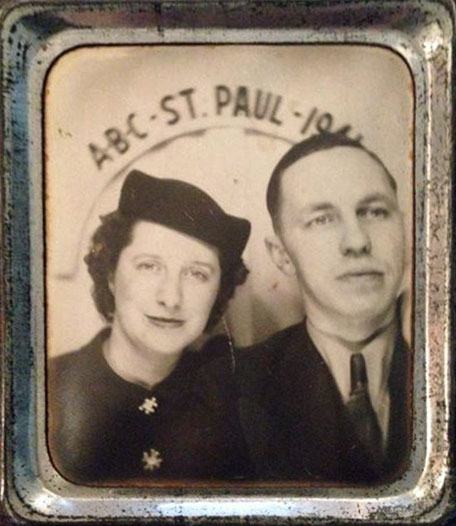
See Herb’s.
560 St. Anthony, St. Paul. First Black restaurant in Minnesota to have a legal liquor license. Demolished in 1960.
Jim’s was located at 717 Sixth Ave. No. (Olson Memorial Highway), next to Howard’s Steak House.

715-717 Olson Memorial Highway. Photo courtesy Minnesota Historical Society
It went back to at least April 1953.
In January 1954 we see Jim Baker’s Black and Tan Club.
The building was demolished in about January 1957.
737 Selby Ave., St. Paul. On February 24, 1957, a gunman entered the bar shortly before closing time and ordered a beer. The then walked be hind the bar and ordered James McKelvey, the owner, to empty the till. Edward Olson, 38, a janitor at the bar, threw a glass at the robber and began to fight with him. The gunman fired one shot from a nickel-plated revolver, took the money, and fled to a waiting car. Olson was dead when the ambulance arrived. The hold-up man netted about $250.
JJ’s Heidelberg was at 708 W. 66th Street at Lyndale in Richfield.
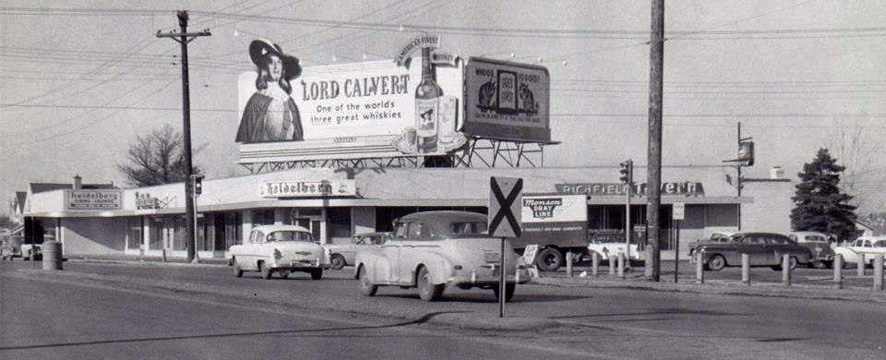
In the 1970s there were three bars:
- JJ’s
- Piano Bar
- Working Man’s Bar
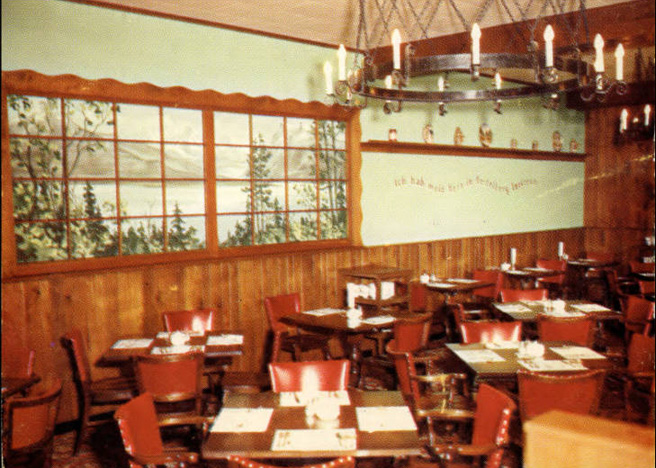
1960 postcard image courtesy Hennepin County Library
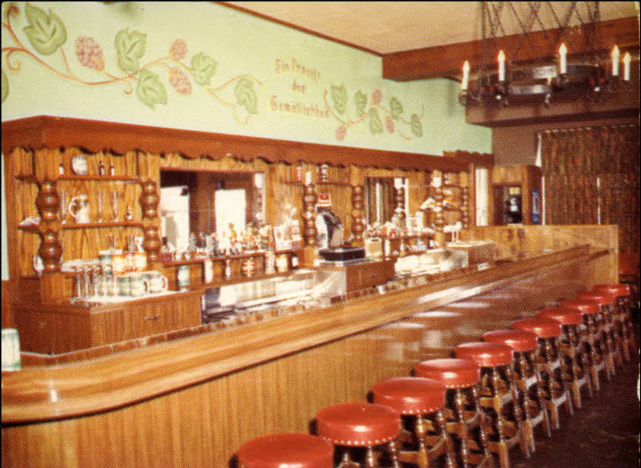
1960 postcard image courtesy Hennepin County Library
THE RHEIN
On September 17, 1971, the Heidelberg opened the Rhein gourmet salon, which featured Michael Hauser on classical and flamenco guitar.
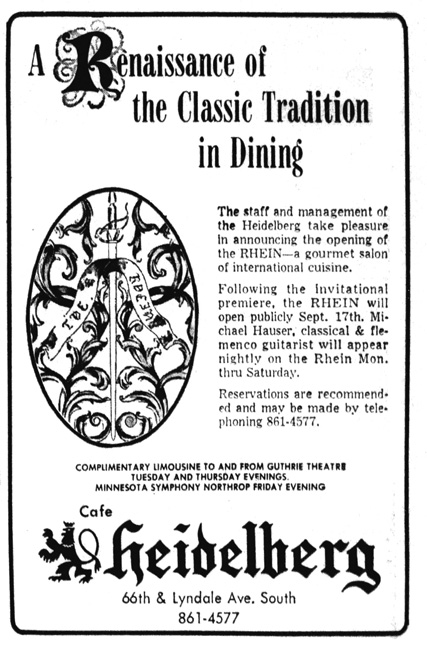
Minneapolis Tribune, September 12, 1971
In 1973-1975, dance to the Frank Wagamon Quintet.
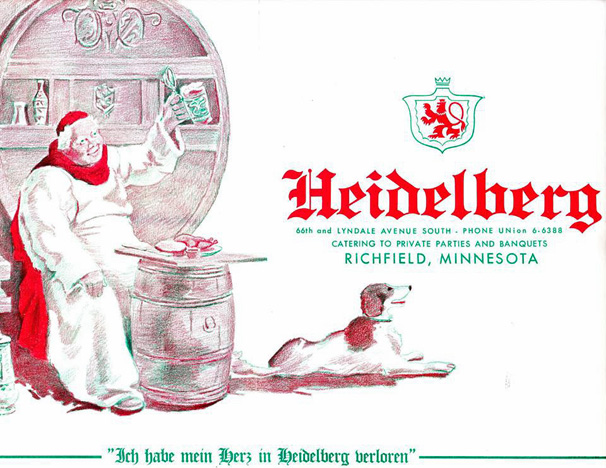
Randy remembers dancing to a band that covered Doobie Brothers songs. Or was it the Eagles? Blackwood was the house band 1974-76.
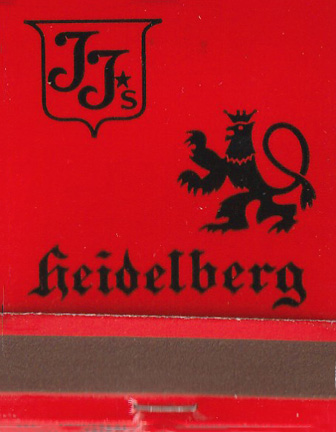
Now the site of Village Shores Senior Living.
See the Loeb Arcade Building.
The Jockey Lounge and the Libation Station were located at 2417 W. 7th in the Sibley Plaza Shopping Center in St. Paul. The Sibley Plaza Shopping Center was built in 1954 in Highland Park, West St. Paul.
SIBLEY “24” BOWLING
The first mention of the address in the Star Tribune is an ad for a bowling alley on February 10, 1958. It was one of several bowling alleys opened by brothers Albert, David, and Joseph Stein. The bowling alley was destroyed by fire on November 29, 1966. The five-alarm fire started in the bowling alley’s newly-decorated lounge and required 15 pieces of apparatus and 55 men to extinguish.
DERBY LANES/JOCKEY LOUNGE
The Sibley “24” Bowling Alley was replaced by Derby Lanes, and within the new bowling alley was the Jockey Lounge. The first ad for the Jockey Lounge shows up on February 29, 1968.
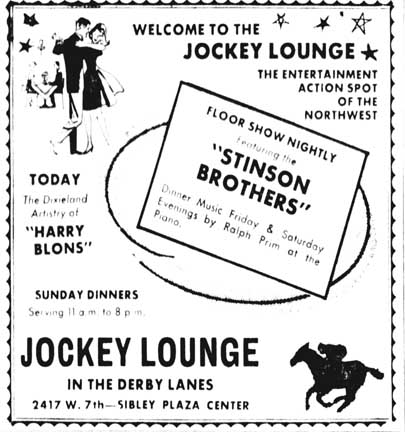
Minneapolis Star, February 29, 1968
On December 19, 1973, James R. Enroth, son of Twin Cities sportscaster Dick Enroth, was severely beaten outside the Jockey Lounge, where he was attending an office party for his employer, Sperry Univac. Enroth was 28 and suffered a skull fracture when he fell to the pavement. He died on December 22. A Blaine man was charged with second degree manslaughter, but the Grand Jury cleared him when it heard testimony that Enroth was the aggressor.

November 16, 1975
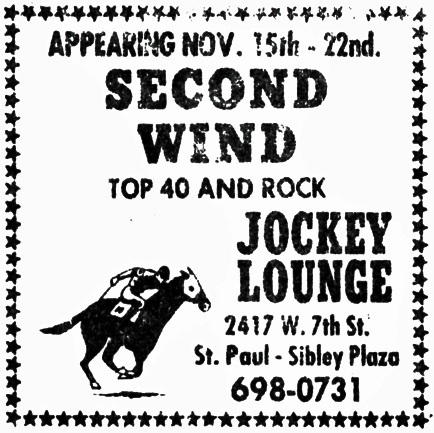
November 14, 1976
The last ad we see for the Jockey Lounge is December 5, 1976.
LIBATION STATION
The first mention of the Libation Station in the Minneapolis Star that wasn’t a crossword puzzle clue appeared on May 31, 1977, in a calendar of events that showed an opening on June 1, 1977. The musical fare was mostly country rock. One of the first acts was the venerable Sherwin Linton!
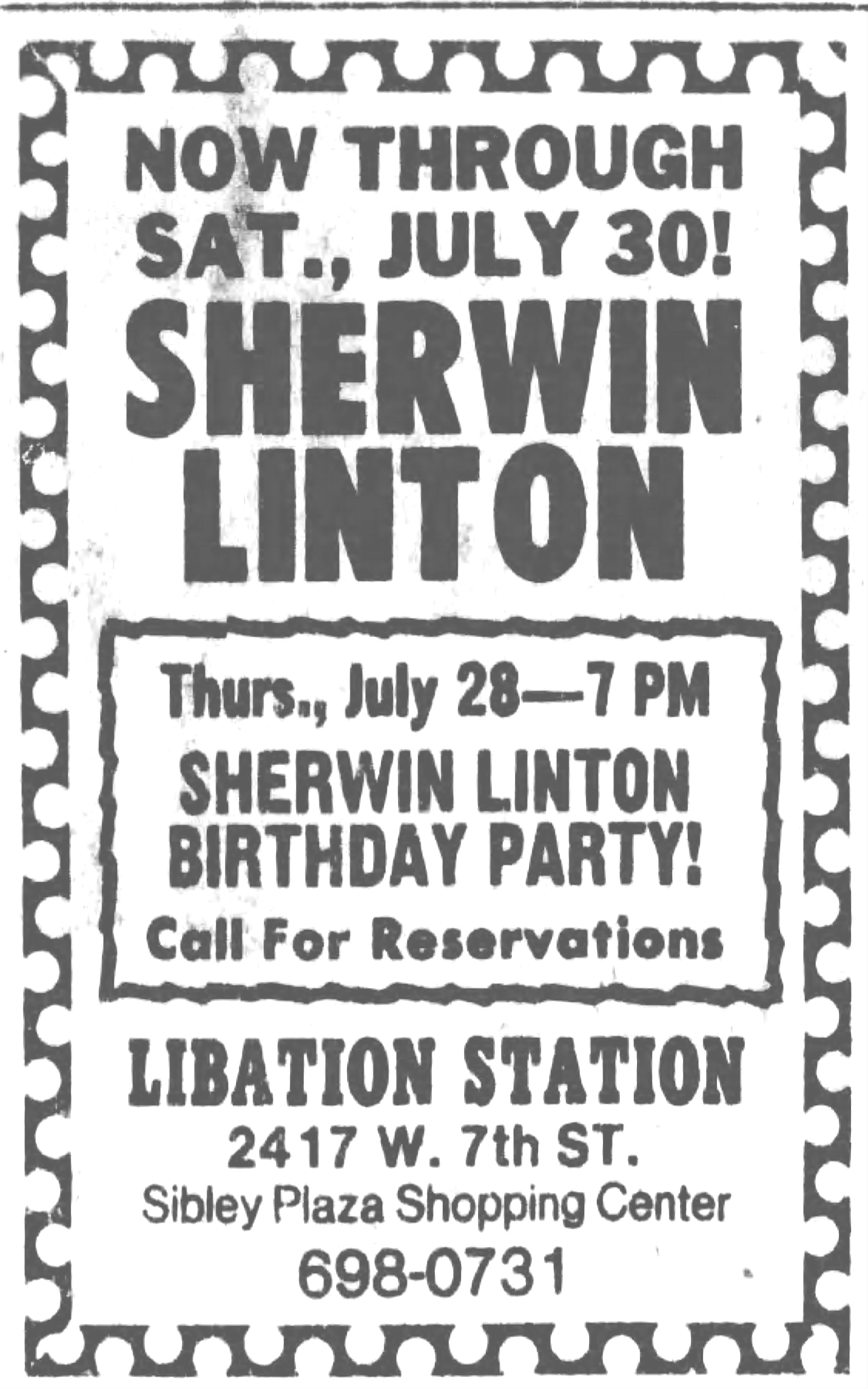
Minneapolis Star, July 21, 1977
Sandra Kenyon’s husband was in a band called Montana Starr, which morphed into db Cooper, and spent some time at the bar in the late ’70s. She says, “It got pretty wild! There was mud and jello wrestling , wet tee shirt contests, and many brawls!”
A man named John Durocher, just out of jail for fraud, purchased the Libation Station and had big plans for a video and pizza delivery service. He owned this location in 1979 but he got arrested again and this time he took it on the run. (Minneapolis Star article by Carol Byrne, March 24, 1986)
In later years the music got harder, with big sound groups like Brainiac and Cain.
Also unclear when the Libation Station closed. The last calendar entry was in August of 1982, but it was included in the Happenings Book issued in November 1984.
In February of 1985 the location became a Goodwill store.
Joe Gans Italian Cafe was located at 860 University Ave. W in St. Paul.
According to Ramsey County (via lyfmap.com), this building was built in 1914. It had a storefront on the ground floor and residences on the top floor.
Not to be confused with champion lightweight black boxer Joe Gans from Baltimore, “Dago” Joe Gans was a rugged welterweight from the West 7th Street District of St. Paul. He apparently went by that name with no apologies, and perhaps to distinguish himself from the other, more famous Joe Gans.
In August 1937 he was heard to say that he was opening up a food spot that’ll be the the talk of the town. Sportswriter Percy Villa deemed him still to be a handsome guy.
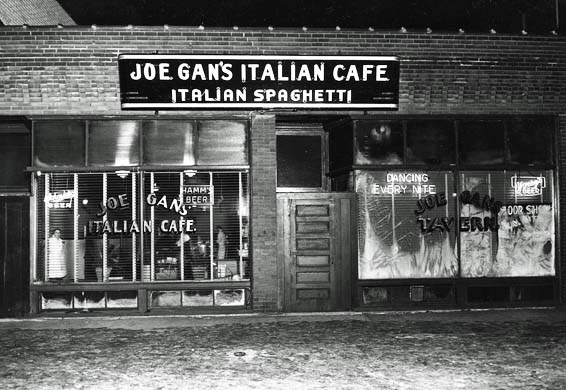
1950 photo courtesy Minnesota Historical Society via lyfmap.com
A blurb in the Minneapolis Tribune on December 30, 1943, said that Joe was doing all right with his restaurant, where he specialized in Italian dishes.
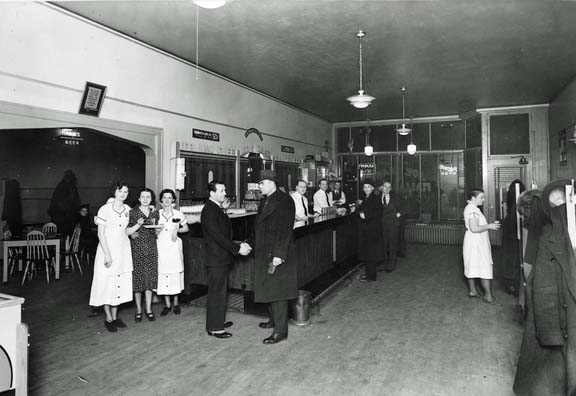
1950 photo courtesy Minnesota Historical Society via lyfmap.com
One thing we do know is that the Cafe did offer “Dancing Every Night,” as it says in the window in the first photo above. In the photo below, there is a sign that promises a Floor Show. Is that Joe in front of the ladies in white?
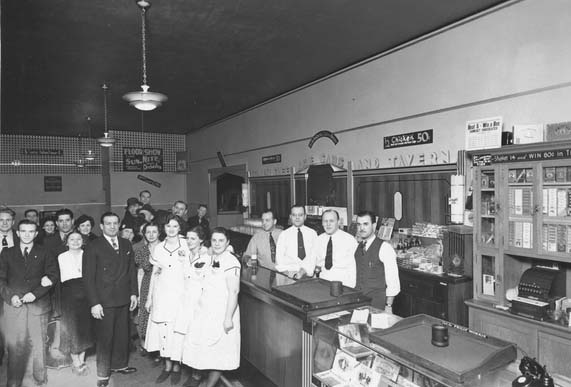
1950 photo courtesy Minnesota Historical Society via lyfmap.com
And this must be the Joe Gans Orchestra. Space was at a premium at Joe’s!
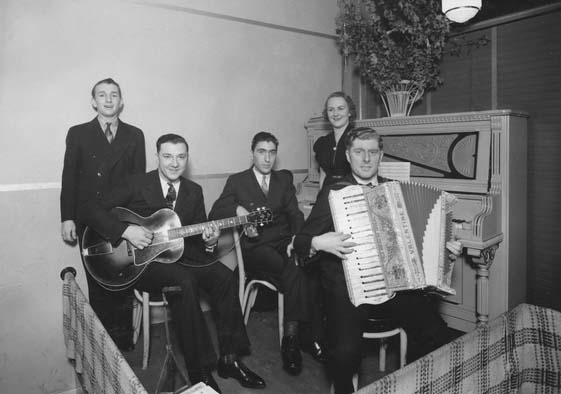
1950 photo courtesy Minnesota Historical Society via lyfmap.com
Since this venue was in St. Paul and the St. Paul papers are not online, information is scarce. I do believe Joe’s was still there in 1955.
This ad from 1939 is only here to represent the Barbeque places that abounded, especially in the black community, where great music could be heard. There may not have been permits, they may not have adhered to regular hours, and they may not even really advertised, but music and Barbeque kind of went together.
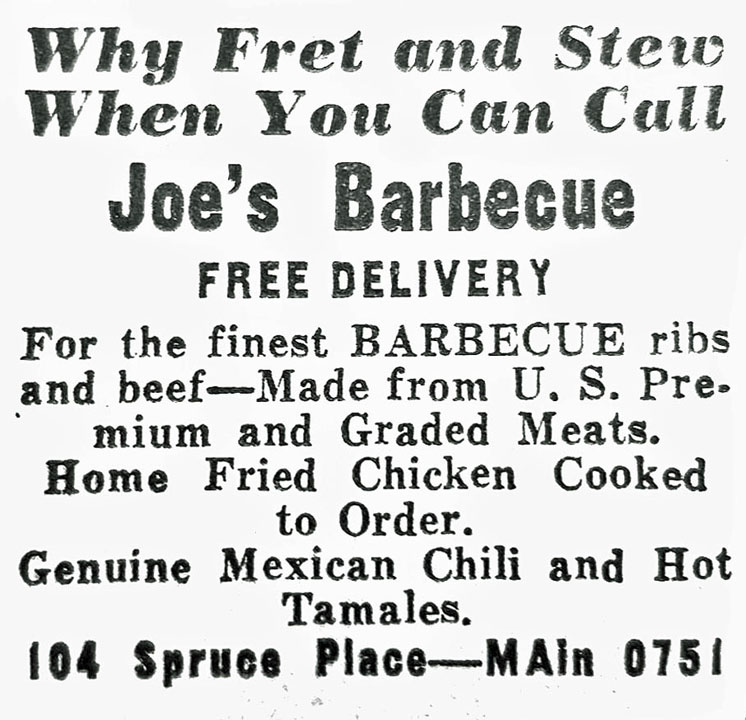
1939
2251 University Ave., St. Paul. No information whatsoever, but Mark Youngblood has this ashtray so it has to be a swanky place.
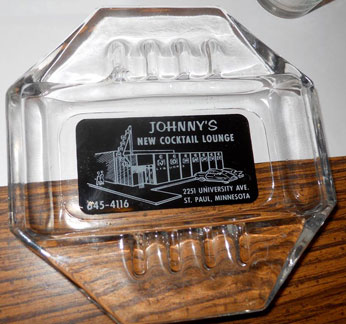
This classic building at 913 Cedar Ave. was built in 1902.
THE REX BAR
In 1941 the Rex featured Good Scandinavian Music. There you could meet John Freberg, former Swedish Championship Wrestler, and Chris Glamsrud, Bartender Supreme.
THE JOINT
In 1971 it became the Joint. “What it Is” was reportedly the house band, 1973-75. In June 1974 the Joint was owned by Jim Annin, and Charlie Campbell of Labor Temple fame was booking blues acts.
The Joint threatens to close in 2017.
This restaurant at 8301 Normandale Blvd. in Bloomington went through a head-spinning number of iterations. The building was built in 1971, sits on 2 1/2 acres, last sold for $5 million in 2006, and belongs to a couple in California.
This is what I’ve gleaned from Facebook:
JOLLY GREEN GIANT
This was a restaurant/bar that was apparently so-named because employees of the nearby Green Giant corporate headquarters would eat there. It had a green roof, and when you walked in you could see the Giant’s big boots and his big chair. And you’d better eat your peas!
Barbara Flanagan mentioned the “new” Jolly Green Giant Restaurant in her December 16, 1969, column. This does not jibe with the 1971 date of the building, and Alan Freed says there was another one? Stay tuned.
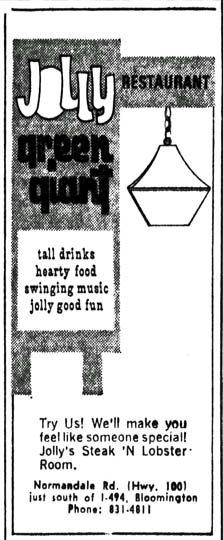
Identical ads were in the Minneapolis papers in December and June 1972
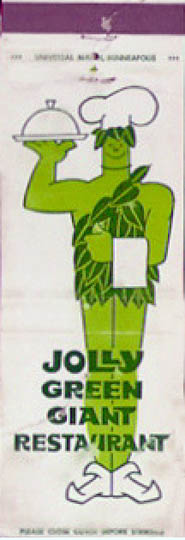
Courtesy Alan Freed
HENRICI’S
This venue was around in December 1973.
STONEWINGS
TONY ROMA’S
MAJOR’S
POOR RICHARD’S COMMONHOUSE
At the Lilac Lane Restaurant and Cocktail Lounge, Highway 100 and Excelsior Blvd., St. Louis Park. 1963 entertainers were Susan Aldrich and Keith Gamm.
Please see Tafi’s
The Junior Pioneer Hall was built in 1909 and was (and is) located at 192 West 9th Street (at Exchange Street) in St. Paul. It was owned and no doubt built by the Junior Pioneer Association.
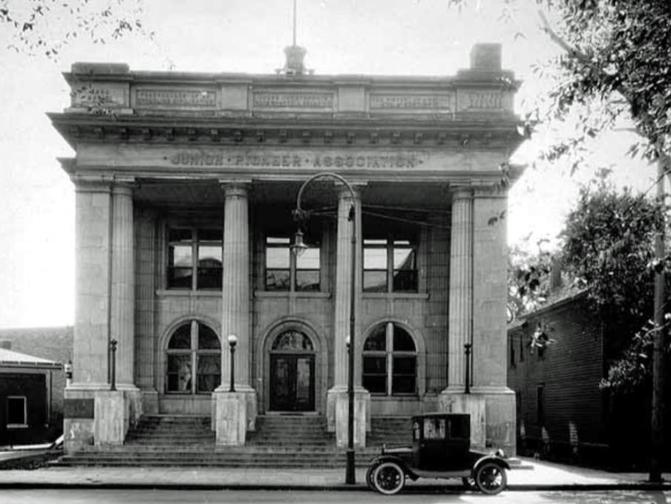
1925 photo courtesy Minnesota Historical Society
DANCES IN THE ’50s
There were spaces upstairs and downstairs for rent; 1962 bride Cathy Long says, “If I am remembering correctly, the upstairs would be perfect for a dance. At that time it was a huuuuuge room with a stage and wood floor.”
Judy Perkins (Percy Hughes’s wife) and her Combo performed at a golf tournament dance there on July 28, 1951.
Little Richard appeared there in 1956. On June 22, the St. Paul Recorder reported that:
Dance and jazz fans of the Twin Cities will be in for a special treat when the “original Tutti Frutti Man,” “Little Richard” and his orchestra play for a dance at the Junior Pioneer Hall, 192 W. 9th St., St Paul, on Tuesday, June 26, 8:30 to 12:30.
The “Rock and Roll Rage” with a dynamic personality received national recognition a few months ago with his recording of “Tutti Frutti,” and since then he has become one of the greatest stars on the musical horizon.
Al Smith and the Moroccans provided the music for a dance at the hall given on March 30, 1957. The review by Jemal Jackson in the St. Paul Recorder on April 5, 1957, wasn’t so hot – apparently the group didn’t start together – but they were fine on record.
The Ray Charles Orchestra made an appearance on January 16, 1958, announced the St. Paul Recorder.
Larry Fisher and his Band, February 8, 1958. This appears to be the last dance advertised in the local papers.
From 1963 to 1973, the building served as the University of Minnesota’s St. Paul General Extension Center.
In 2013 it was occupied by Reigstad & Associates, who turned the gym into offices. They didn’t allow tours.
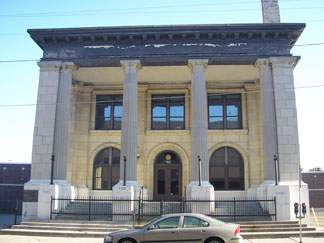
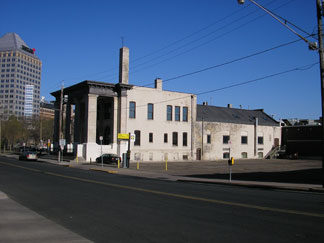
Junior Pioneer Hall, 2013. From the side (right) you can see what might have been the gymnasium where Little Richard played!
This page traces a series of musical venues that existed at 242 Nicollet Ave. in Downtown Minneapolis.
THE BUILDING
The history of this building is difficult to figure out, because the permit card starts with an alteration to an existing building – dated 1885. Then it looks like part of it was demolished, and it was rebuilt in 1905 at a cost of $40,000. It’s clear that early on it was the site of a saloon, but there were so many selective demolitions that it takes a greater mind than mind than mine to sort it out. The dimensions when it was finally demolished for good were 40 x 90, four stories. A note from 1920 mentions that it was called the Old Kaiserhoff Building.
KAISERHOFF RESTAURANT
Max Ziemer was the proprietor of the Kaiserhoff German restaurant at 242-244 Nicollet Ave. in November 1913.
In May 1916, it was advertised as the New Kaiserhoff, at 242 Nicollet. Music was furnished by the seven-piece Ladies Orchestra.
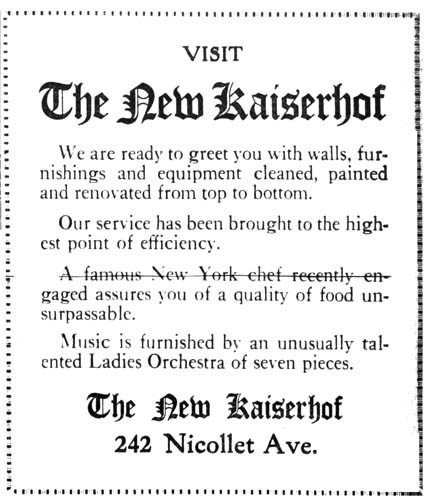
Minneapolis Tribune, May 4, 1916
AMERICAN CAFE
In a prototypical move around the time of World War I, the German name of this restaurant was changed to the patriotic “American Cafe” in about September 1917. To add to the American theme, the Blue Plate Special was dubbed the Hoover Plate Service. Music was provided by an eight piece combo playing New Orleans Jazz.
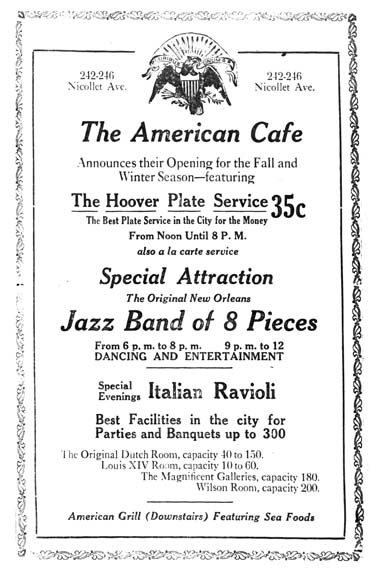
Minneapolis Tribune, September 11, 1917
In May 1918, owner Max Ziemer was brought to court on charges of violating the State Public Safety Commission orders regarding sales of liquor to women. This violation was commonly known in the press as “Lid Tipping,” or tipping open the lid on the rules that kept the town decent and crime free. I just happened to see this postcard on Facebook that demonstrates the Lid being held down in Minneapolis.
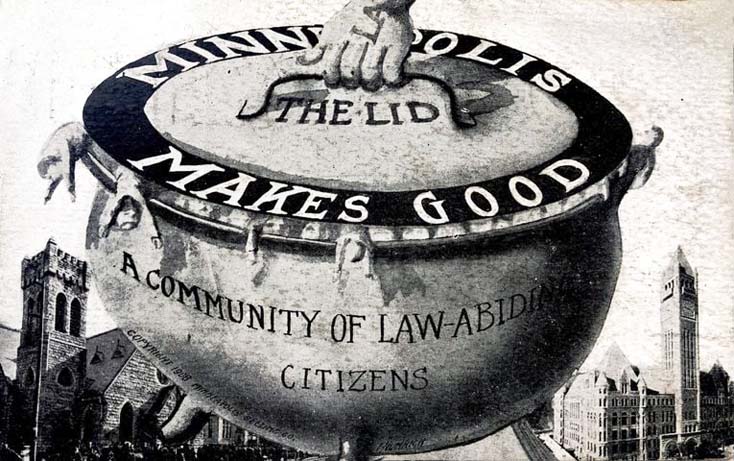
1908 postcard courtesy Stewart Hall
When the New American Cafe opened on September 2, 1918, patrons were promised a Jazz Band concert, but no liquor was served. The manager was Jack Thompson.
In February 1919, the Auto Show was in town, and the night clubs all vied for business from in-town and out-of-town guests. The Garden City Quintet provided the musical entertainment. In case that that couplet is hard to read, it says,
“Never since the world began
Has wholesome fun hurt anyone”
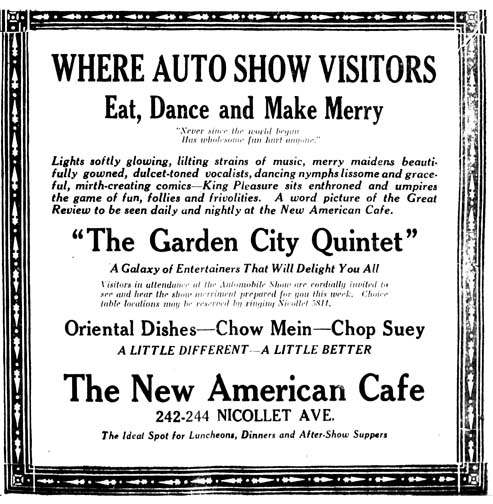
Minneapolis Tribune, February 16, 1919
But alas, on April 20, 1919, Max ran afoul of another Lid Tipping charge, and by August 1920, the New American Cafe appears to be gone.
The Kasota Legion Hall in Kasota was listed as a venue by the Insider 1971-74.
2221 Ford Parkway across from the Ford Plant. Country bar in 1973. Associated with (same owner as? the Manor.
At this notorious location at 1327-29 Washington Ave. So. you could hear the sublime, if you could get there alive!
HENRY SABES
South of the Border and the Key Club were owned by Henry Leonard Sabeswitz, who was born in 1909 in Minneapolis. He had his name changed to Sabes by court order before he was 31 years old. His parents were both born in Russia, and he was one of at least nine children. The family immigrated to America in 1900, and in 1920 his father was a fruit peddler.
In 1933, Henry was a clerk at the JB Hanson Grocery Store at 608 Filmore Street NE. It appears this building was torn down in 1934. He was robbed in August of that year.
In 1942, he was a partner in the American Sales Co., with Charles Berman. The company operated pinball machines and jukeboxes and placed them around town. In 1952 there was an investigation into the operation and in August he surrendered to Federal officials as a material witness.
He was also a stockholder and one of the organizers of Mercury Records.
“Hank” and his wife were active members of the Jewish community in Minneapolis, philanthropists, and he was an avid golfer. He died on November 21, 1994.
SOUTH OF THE BORDER: 1327 WASHINGTON AVE. SO.
The South of the Border Bar had been a Cafe before Sabes opened it in about August of 1939.
This venue appears to have been merely a bar. In 1963, Sabes testified that he had owned his property for 25 years. That would compute to 1938.
KEY CLUB: 1329 WASHINGTON AVE. SO
The Key Club was next to South of the Border. This had been the Bon Ton Cafe, going back to at least December 1926. There were two earlier references to the Bon Ton Cafe, but there was no address, so it’s unclear whether it’s the same place. The 1916 Bon Ton was described as “a greasy looking place about as big as a dog house.” (Minneapolis Tribune, May 13, 1916)
For a few years it was Joe’s Tavern, run by Joel Carlson until he got caught selling beer to minors. For this he lost his license and got sent to the Workhouse for 30 days. Joe’s tenure was from about May 1937 to January 1944. (Minneapolis Star, January 13, 1944)
Next was the Silver Star beer parlor, owned by Marie Janen. Oh, the stabbings! One terrible one was on July 4, 1946, and then there was another one – two women fighting about one husband – involving a hand axe and a pocket knife. Both of them were given 30 days in the Workhouse.
1951
There was no reason given, but in August 1951, owner Janen was ordered to move. She wanted to move to 1323 Washington Ave. So., but it was deemed to be too close to the Children’s Gospel Mission, at 1407 Washington Ave. So. The City was attempting to crack down on its ordinances about distances between bars and churches.
Just how the Key Club was allowed to move into the space is not clear, but it opened on December 19, 1951. The club featured top notch entertainment, especially jazz and rhythm & blues.
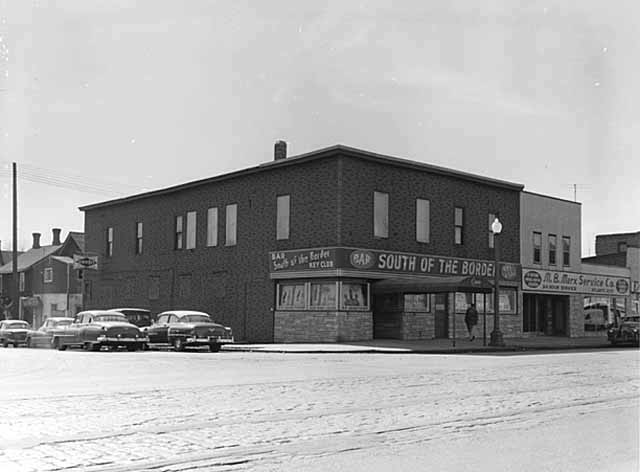
Key Club/South of the Border, April 1, 1955. Photo courtesy Minnesota Historical Society
ENTERTAINERS AT THE KEY CLUB
NOTES:
Only known dates are given. Appearances may have started or ended before or after the dates provided unless definitely stated.
My comments seem redundant to the text on the ads, but the ads are not searchable, so I repeat them for those searching for particular artists.
Many of the uncited performers come from notes out of the Minneapolis Spokesman, the weekly newspaper serving the black community since 1934, published by Cecil E. Newman. Now that that publication is online, I hope to go back and search that database for more ads.
There will be many references to Will Jones – he was the entertainment columnist for the Minneapolis Tribune, and a treasure trove of information.
The first group to appear at the Key Club were the Four Blazes. They were in-house as of opening night until the end of January 1952, per Will Jones.
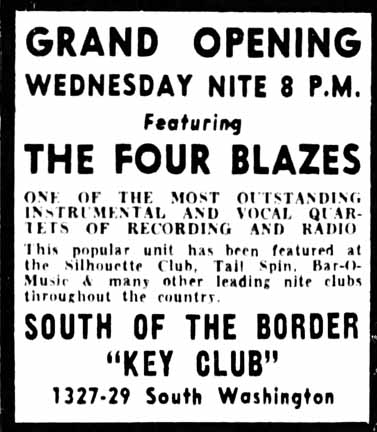
Minneapolis Star, December 18, 1951
1952
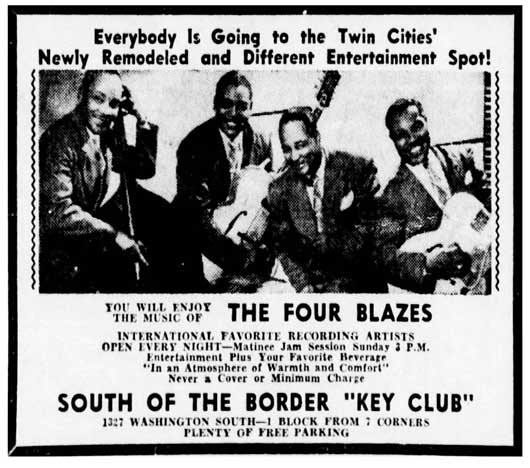
Minneapolis Star, January 4, 1952
The Key Club promised “They Key to Pleasure in Fullest Measure.”
On January 18, 1952, Will Jones noted that every Sunday from 3 to 7 pm there was a jam session that left him with a “limp set of ears.” Chet Christopher’s bop group was the base, but as many as 20 musicians might sit in.
Jones said that customers sign cards and are issued keys. The keys don’t unlock anything, said Manager Frank Sloan. “Some joker might lock everybody in.” Later Sloan clarified that customers didn’t need the cards or keys to get in – they “give people an idea of being special.”
Irv Williams’ Quartet had moved into the Key Club by February 22, 1952, and became a sextet on Sunday jam sessions.
On March 5, 1952, 12 people were arrested after raids by Federal narcotics agents and the Minneapolis police morals squad. One of those arrested was an independent photographer working at the Key Club, who was arrested after narcotics agents bought marijuana cigarettes from him. (Minneapolis Star, March 5, 1952)
Cozy Eggleston’s Combo
The Delta Boys, “America’s Finest Sepia Combo”
Hank Hazlett
Little Donna Hightower, Decca’s famous recording artist
Stomp Gordon Combo, “King of Bop and Boogie – the Character who stomped his way to fame with his All Star Combo”
1953
“Always something new at the Key Club, where we make things happen”
The Five Young Moderns Jazz Group appeared from April 3 to May 8, 1953. The group featured Lou Levy, formerly of the Woody Herman Band. “Hottest Jazz band in the country.”
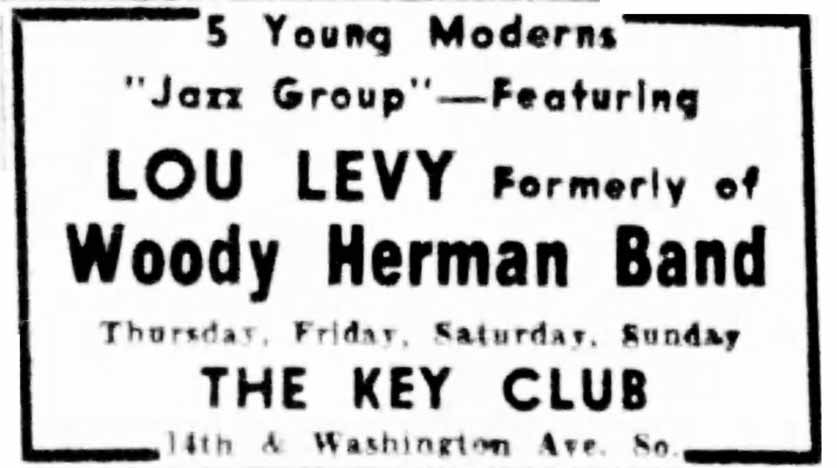
Minneapolis Star, April 3, 1953
In August 1953, the performers were the Hank Hazlett Trio and four vocalists featuring Little Donna Hightower – “Man Alive it’s Jump & Jive Music With Drive” On August 11, Will Jones called Little Donna a Bop Singer, and said that she liked it in Minneapolis so much that she bought a house here and was booked indefinitely.
Scat Johnson Trio
Great Jimmy Binkley, Blue Note recording band
Bill Boone, the Man with the Horn
1954
Five Cats and a Kitten
“Peewee” Glover, sensational sax player
Earl Jackson and His Trio, D.P. Black, promoter
Four Gentlemen of Jest, D.P. Black, promoter
Oscar Frazier and the Four Notes
Erice Giere, Stanley Williams on drums, Ira Pettiford
Hank Hazlett
Wild Bill Boone
1955
1955 started out with Wild Bill Boone, and extremely popular local entertainer.
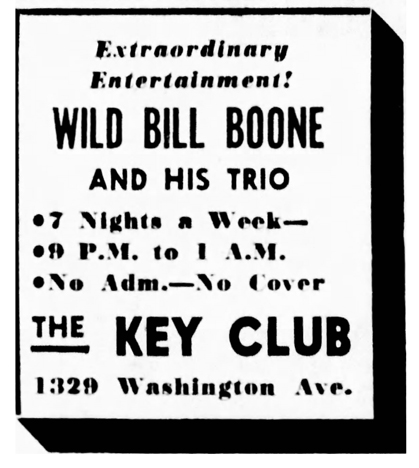
Minneapolis Star, January 6, 1955
Boyd Moore Combo featuring Eva Gee, blues and torch singer, fresh from extensive eastern tour
“Nature Boy” Brown sax and his Harlem Playboys, direct from Chicago
1956
The Key Club really came into its own in 1956, just as other venues seemed to be slowing down – at least according to ads in the Minneapolis Spokesman.
Hank Hazlett Trio, January 30, 1956
THE STAFFORD KIDNAPPING
On February 15, 1956, singer Helen Stafford was kidnapped from her apartment above the Key Club. She and her husband had been playing cards when three men broke in. She jumped out of her second-story window, suffering rib and shoulder injuries. The men forced her into their car and “forced her to submit to indecencies,” she told police. They released her at Sixth Street and 19th Ave., where she went to the nearest house for help in the two below zero weather. Meanwhile, her husband had seen the men take off in a two-tone green car, which he reported to the police. In the apartment, the police found a pencil with the name of a St. Paul night club on it. St. Paul police were alerted, and the car was picked up at Larpenteur and Hamline after a high speed chase. The driver was tagged for speeding before they were turned over to Minneapolis. All three men were charged with sodomy; one was acquitted, one plead guilty, and the other plead innocent. (Minneapolis Star, February 15 and March 24, 1956)
Eddie “Cleanhead” Vinson, orchestra leader and saxophone player, began an indefinite engagement at the Club starting March 19, 1956. “This fabulous orchestra will set a policy of ‘better’ entertainment at the Key Club. Music as you like it plus exotic dancing.” With the new policy came a 50 cent admission fee on the weekends. (Minneapolis Spokesman, March 23, 1956)
Jimmy Witherspoon, blues singer; Betty DeQuincy, dancing entertainer fresh from Detroit; Stomp Gordon and His Combo, starting April 16, 1956.
Duke Groaner and His Combo plus Audrie DeYoung, exotic dancer, May 14, 1956
Bob Wilson and His Combo plus Black Velvet, interpretive and exotic dancer
Tiny Davis and Her Hell Divers took the stage from June 25 to July 2, 1956. The ads called them “The Rock and Roll Queens,” but they also played calypso, bop, and “funny-hat music,” according to Will Jones. She charged through the club blowing a five-foot long trumpet made in Germany, and a nine-inch-long trumpet made in Italy. She was fond of sitting in customers’ laps. The group once had 18 members but was now down to five. (July 2, 1956)
Camille Howard, song stylist and pianist; Larry Rice and Combo; comedian Mickey Martin, emcee, July 23, 1956
Billy Brooks and Piney Brown, song stylists; Jimmy Binley Combo, August, 1956
Larry Wrice and His Chicago All Stars; Florence Devereaux, song stylist; Tequila, exotic dancer, October 5, 1956
Miss Wiggles was an exotic dancer on the bill at the Key Club as of October 29, 1956 and into in November. She was billed as “The Upside Down Girl.” Will Jones wrote that “She does everything other exotic dancers do, only she does it upside down, while standing on her head. It’s weird.”
Rudy Hunter and the Fabulous Tones (from Hollywood), November 29, 1956
Dozier Boys, Fresh from Chicago, December 15, 1956
Dozier Boys and Chubby Newsom, vocalist from Detroit, December 21, 1956
On New Year’s Eve, 1956, Will Jones wrote that the Club was raising its cover charge from 50 cents to $1 for the evening. The entertainment was Rock ‘n’ Roll music and a stripper named Black Velvet. They were taking reservations “for people we know.”
1957
Jimmy Rogers was a “Marathon Drummer” who could play for 80 hours straight, supposedly. He began an extended appearance at the Key Club on January 17, 1957, along with a combo of organ, guitar and sax. Rogers had appeared on the “Today” show, and had been featured in numerous magazines, wrote Cedric Adams in the Star (January 22, 1957). Different singers and exotic dancers appearing with him through February.
On February 8, 1957, Beulah Bryant, “400 Pounds of Dynamite,” took the stage. She was described as a blues singer, and although she does not appear on the imdb.com list of cast members of “Gone With the Wind,” her singing may have been heard in the movie. Also on the bill was exotic dancer Lola DuConge and the Jimmy Rogers Quartette.
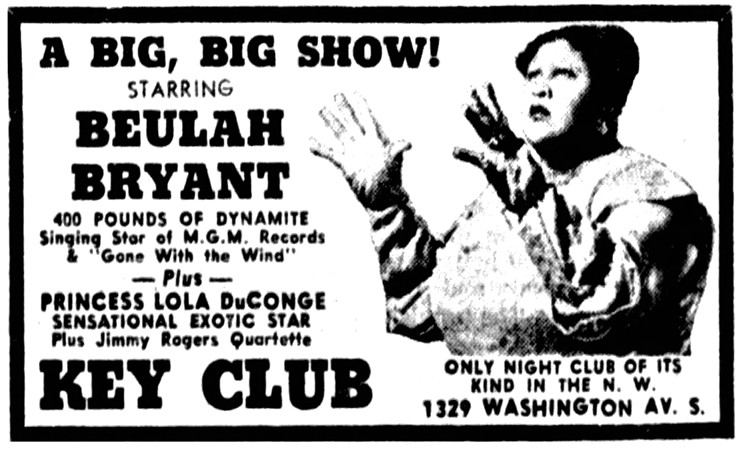
Minneapolis Star, February 8, 1957
THE TALLEY SHOOTING
On February 24, 1957, at about 1:15 am, Sabes shot and killed Charles Maurice Talley, a 30-year-old singer and musician at the South of the Border. Talley, who had been drinking, got into an argument with Robert H. Johnson, 26, who accused Talley of paying too much attention to his wife, Allene. (The Johnsons were apparently from New Jersey and were at the bar with Allene’s mother.) Johnson pushed Talley, who retaliated by firing three shots at Johnson with his German automatic pistol. One shot hit Johnson in the ankle. Sabes rushed in and Talley fired two shots at Sabes. Sabes ran into a telephone booth and fired three shots at Talley with his snub-nosed .38 revolver. Talley was dead when police arrived. The Grand Jury determined that the shooting was self-defense. Talley was wanted on two warrants for abandonment and non-support.
On February 23, 1957, Emily Foster was the featured vocalist with Jimmy Rogers’ Combo. Cedric Adams found her to be “a bombshell of talent and showmanship and had the capacity crowd hoarse from shouting for more.” He wrote that some have called her “the female Sammy Davis, Jr.” (Star, February 26, 1957
HORACE HENDERSON
Decca recording artist and pianist Horace Henderson (brother of Fletcher Henderson) and His Rock ‘n’ Roll Combo began an extended appearance at the Key Club in March 1957. Henderson was a pianist-arranger for Lena Horne for two years, arranger for Charlie Barnet for three years, and also worked for the Benny Goodman and Jimmy Dorsey Bands. (Will Jones, August 29, 1957) His first show was advertised as a “Big Floor Show.. With Plenty of Sock.” Henderson would appear at the Key Club off and on until 1960.
Don Morrison wrote in his column that the Club passed out miniature drum sticks to the customers for drumming along with the music. (Tribune, April 29, 1957)
Other entertainers appearing at this time included comedy team Butterbeans and Susie (a/k/a Jodie and Susie Edwards).
From June to August 1957 the headliner at the Key Club was Rose Mary Gaiters, a singer “Second only to Ruth Brown,” with the Duke Groner Combo and a rotation of exotic dancers (one billed as a “variety girl.”)
National act Jay McShann, “The Band that Jumps the Blues,” appeared at the Key Club in August 1957 with the Rhythm Kings Trio (singers-dancers-comics-acrobats). Will Jones described Princess Lola De Conge, popular exotic dancer, as “another of the new crop of upside-down dancers who stands on her head on a chair to produce her most interesting wiggles.”
Jones also reported that the Club had another new roomful of tables from which the show may be seen. (August 9, 1957)
On August 29, 1957, Will Jones wrote that the Club was resuming its vaudeville policy with Horace Henderson’s house band and five acts.
In August 1957 Jimmy Binkley and his Popular Combo, the Dutch and Dutchy comedy team, and Lottie the Body were the featured performers at the Key Club.
Roy Milton and His Solid Senders appeared at the Key Club in September 1957 with Johnny “Guitar Jr.” Rogers and Tequila, Tempest of Dance. Will Jones was sorry to see Lottie the Body being replaced, if only for her name. The featured singer was a woman named Mickey Champion, who wore a fringed dress to emphasize her “shakes,” as Jones called them. (September 27)
ROY ELDRIDGE
The photo below is the only one I’ve seen of the inside of the Key Club. It was identified by the Minnesota Historical Society as Ira Pettiford and Roy Eldridge, but no date or year. So far I could not find a personal appearance by Roy Eldridge, but he was in town every fall with the Jazz at the Philharmonic troupe, from 1952 to 1957. The Key Club would have been a natural place to relax after the show. Best as I can figure out, and please correct me if I’m wrong, the photo shows Pettiford on the left, a member of Eldridge’s band in the middle, and Eldridge on the right.
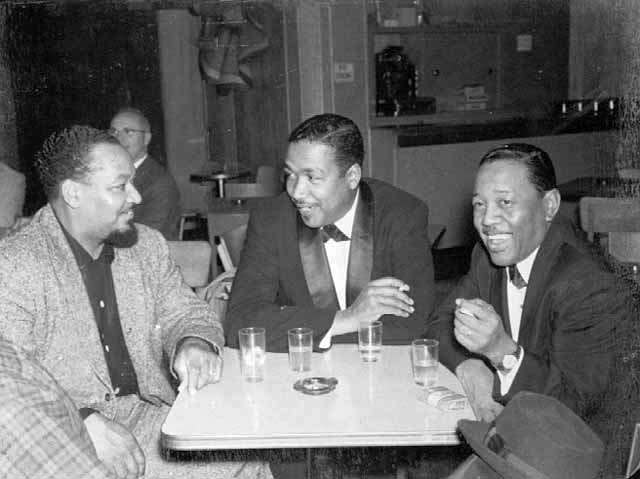
Photo courtesy Minnesota Historical Society
Bullmoose Jackson and His Buffalo Bearcats performed at the Key Club in November 1957. Also on the bill was “the very popular singer and dancing star Vi Kemp – A Daring Performer.. a touch of genius.”
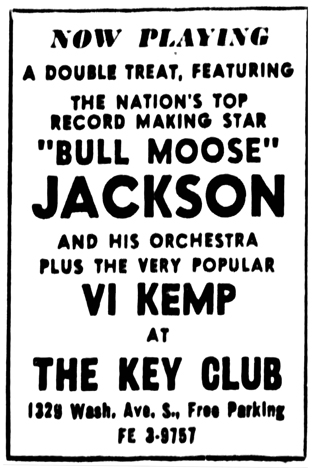
Minneapolis Tribune, November 8, 1957
Mercury Recording Star Sil Austin opened at the Key Club on December 2 , 1957. Austin was a saxophonist, known for his instrumental, “Slow Walk.” Also on the bill were Olivette Miller, the World’s Greatest Swing Harpist, and Bert Gibson, Sensational Tap Dancer.
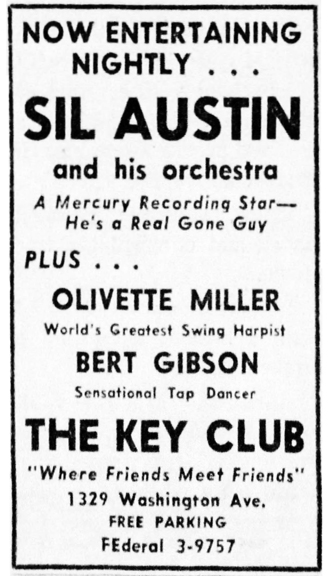
Minneapolis Tribune, December 7, 1957
The Key Club’s 1957 New Year’s Eve show featured the Rhythm Kings (dance, song, comedy), Ira Pettiford and His Orchestra, Wild Bill Boone, Mel Carter, and exotic dancer Lady Ducongue.
1958
On January 9, Will Jones ticked off the acts he had seen the night before: Singer Helen Stafford, backed by Ira Pettiford, Wild Bill Boone, et. al. This was followed by Lola DeConge, who was always billed as an exotic dancer, but was described by Jones as a stripper.
20-year-old dancer “Peg Leg” Morfett was at the Key Club in February 1958 and was spotted by a talent scout and sent to New York. Will Jones wrote that “The lad does turn out an amazing performance considering that one of his dancing legs is a piece of hickory.” (February 12, 1958) This insensitivity might be excused when the parents of a seven-year-old boy read the story. Their son also had an artificial leg and had periodically become depressed. They wrote to Sabes, and he invited them down to see Peg Leg dance. Then the plan was for the two of them to have some private time to talk. “And I’ll wager that the dancer will put on perhaps the best performance of his entire career.” (February 21, 1958)
The Four Zeniths
The Singing Falcons
Tiny Topsy
Los Latinos
Chi Chi Valdez the Cuban Bombshell
Myra Taylor
Laura the Body Beautiful
Brother John Sellers opened on July 22, 1958 and held forth until August 3. Will Jones described him as a big-voiced singer of folk, church, and blues songs, and he was sorry to hear that he was leaving. At the Club he concentrated on blues numbers. He was reportedly going to New Orleans to appear in the movie “Great Gettin’ Up Morning,” with Mahalia Jackson.
NATIONAL ACTS
In August 1958, however, the Club started bringing in some serious national acts:
The Ink Spots performed at the Key Club for two weeks starting on August 4 to 17, 1958. Also on the bill were Pete and Repeat, and exotic dancer Lola De Conge. Horace Henderson headed the house band.
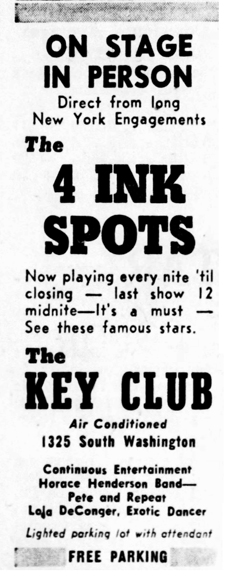
Minneapolis Star, August 6, 1958
Ruth Brown, the “Queen of R&B,” appeared on August 18 and 19, 1958. She shared the stage with such acts as Pete and Repeat, and Exotic Dancer Lola DeConger. The house band was led by Horace Henderson.

Minneapolis Tribune August 18, 1958
La Vern Baker appeared for a week from September 15 to 21, 1958. She was red hot at the time. On the bill with her was Crip Hurd, “Most Unique Dancer, and the Foucee Dancers, Afro-Cuban Stylists. The Horace Henderson band was the house orchestra.

Minneapolis Tribune, September 15, 1958
Al Hibbler was a blind singer who first made “Unchained Melody” popular in the U.S., making his version of the song Number 5 on the Billboard charts in 1955. Hibbler had sung with the Duke Ellington band for eight years. He appeared at the Key Club from October 3 to 12, 1958, and was paid a record $3,000. “This is the real test to see if we can make it with names,” said Sabes.” Also on the program were comedian John “Q” Nuts and the Horace Henderson house band. The Fouchee Afro-Cuban Dancers, including the “wiggling Peaches Slayden” were part of the Harlem in Havana show at the State Fair, and stayed on to round out the bill. (Will Jones, October 1, 1958)

Minneapolis Tribune, October 2, 1958
Will Jones had great things to say about singer Lurlean Hunter, a “willowy contralto,” from Chicago, who performed from October 13 to 21, 1958. Apparently boisterous crowds were a problem, because Ms. Hunter could hush one. Also on the bill was Pete Digges on vibraharp and the Afro-Cuban style Fouchee Dancers.

Minneapolis Tribune, October 17, 1958
Earl Bostic, King of the Alto Sax, graced the stage of the Key Club on October 22 and 23, 1958. Ernestine Anderson handled the vocals.
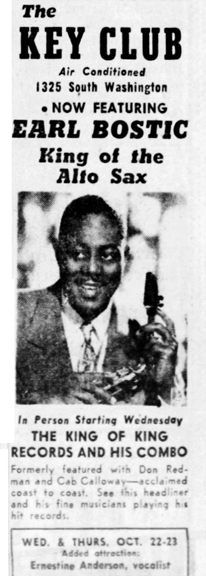
Minneapolis Star, October 22, 1958
The Treniers were indeed Fabulous, and they came to the Key Club on October 31, until November 9, 1958. What an act! In 1956 alone they appeared in Alan Freed’s “Don’t Knock the Rock” and the priceless “The Girl Can’t Help It” – two of the most classic Rock ‘n’ Roll films of all time! In the 1940s they were already playing “Rockin’ Is Our Business,” one of the quintessential proto-rock songs of all time. Here they are on the Martin and Lewis show doing that fabulous song!
Will Jones called them sensational, and wrote that they were blowing the roof off the Key Club with their frenzied and feverish antics. (November 7, 1958)
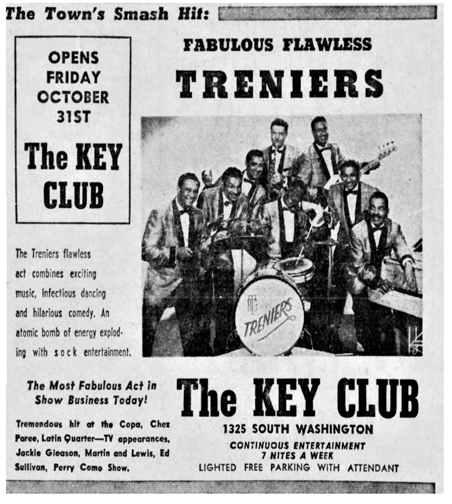
Minneapolis Tribune, October 31, 1958_
On November 13, 1958, Will Jones reported that there was more remodeling going on at the continually-expanding Key Club to accommodate the larger crowds that the big name act policy had been bringing in. The place was to have the capacity for 400.
Billy Williams and his Quartet performed at the Club from November 17 to 30, 1958. Billy’s signature song was his version of Fats Waller’s “I’m Gonna Sit Right Down And Write Myself A Letter” in 1957. The record sold over one million copies. His trademark was to shout “Oh, Yeah” at the end of lyrics.
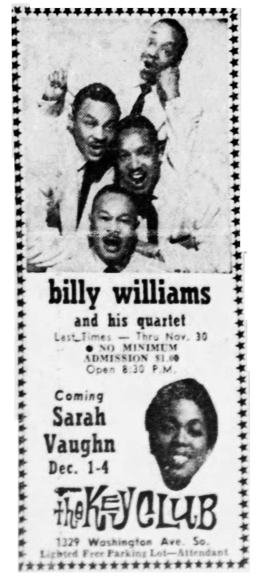
Minneapolis Star, November 29, 1958
THE KEATON MURDER
On November 20, 1958, Morris N. Keaton and an unidentified man had an argument over a mechanical bowling game at South of the Border. William L. Ferrell intervened, and a scuffle broke out, in which Ferrell struck Keaton, breaking his glasses. Both Keaton and Ferrell were bounced from South of the Border.
Keaton went home, but then returned to South of the Border, where he stayed until it closed. Then they went to the Old Southern Barbeque, where he again encountered Ferrell. They argued, and Keaton followed Ferrell into the men’ room. Keaton asked Ferrell why he had broken his glasses, and they fought, knocking out part of the bathroom wall. Then Keaton took out a .38 and shot Ferrell twice. Keaton left, went home, emptied his gun, and asked a fellow roomer to drive him to the police station so he could give himself up.
Sarah Vaughan and her Trio had a four day stay from December 1 to 4, 1958. Also on the bill were Pete Digges and his Vibes, and the Horace Henderson Combo. And again Will Jones complained about not being able to hear because of customer “yakking.”

Minneapolis Star, December 4, 1958
Dinah Washington appeared for one week from December 6 to 11, 1958. (See ad above) She was 10 minutes late one night because she found out that some friends from Chicago had come to see her, and she wanted to wear a specific gown, which was back at the hotel. Then she improvised some lyrics to fit the occasion. She had also read Jones’ complaints about not being able to hear, and “belted ever note firmly against the farthest wall of the place.” After the session, she came up to Jones and asked demurely, “Could you hear me, honey?” (Tribune, December 9, 1958)
The Slappy White Revue came to make the audience laugh from December 14 to 21, 1958. Also on the bill were vocalist Jean Turner, and dancing star Tito Cavalaro. Horace Henderson’s Sextet was on hand to provide the music.

Minneapolis Tribune, December 14, 1958
Ben Webster performed at the Key Club from December 22 to 31, 1958. Webster was a tenor sax player with Duke Ellington and Cab Calloway. Also appearing was singer Jean Turner and the Horace Henderson Combo.

Minneapolis Tribune, December 21, 1958
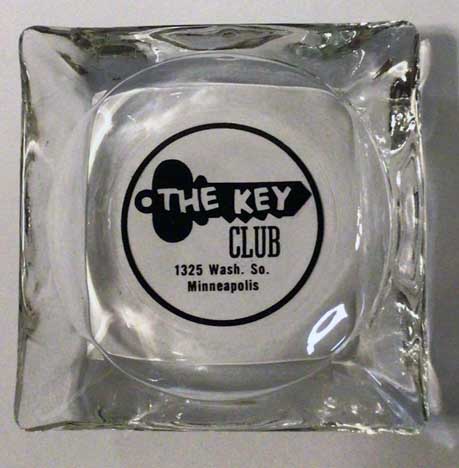
From the collection of Mark Youngblood
1959
Sister Rosetta Tharpe opened the 1959 season. “Sister” was more or less a nickname, she said – she wasn’t Catholic. When she was performing with Cab Calloway she was called “Little Sister.” In 1959 she was 38 years old. Her signature songs were “Don’t Take Everybody to be Your Friend” and “Strange Things Happening Every Day.” (Minneapolis Star, January 5, 1959) On the bill with her were blues singer Jean Turner and exotic dancer Charmaine. The Horace Henderson Combo provided music for dancing.

Minneapolis Star, January 5, 1959
Drummer Cozy Cole and Quintet, featuring Barney Bigard, performed from January 14 to 23, 1959. On the same bill was Big Maybelle. Cole had p;ayed with Cab Calloway, Raymond Scott, Artie Shaw, Benny Goodman, and Louis Armstrong. Cole was mostly known for “Topsy Parts I and II.”
Big Maybelle was apparently held over, at the Club on January 26, 1959.
GOING SOMEWHERE?
On February 9, 1959, for some reason Sabes honked at two Golden Valley police officers who were traveling east on Highway 55 in Golden Valley, while Sabes was driving west. The cops turned around and went after Sabes, who took off. A high-speed chase ensued, with speeds up to 80 mph. They traveled for 40 miles, into north Minneapolis, along Glenwood Ave to Highway 200, to Highway 55 nearly to Hamel, and west again on Highway 55. The police lost Sabes a couple of times, but newly-fallen snow helped them pick up the trail. He was finally stopped by a Hennepin County Sheriff’s roadblock on Highway 55 a few miles east of Rockford at about 3:55 am. Sabes was charged with reckless driving and fined $100. His motivation for the escapade was never revealed. (Minneapolis Star, February 9 and 11, 1959) A subsequent article characterized the incident as drunken driving (Minneapolis Star, April 21, 1961)
Also in February 1959, the Key Club was sued for serving liquor to an intoxicated man who then stole a cab and hit a pedestrian. In December 1960 a settlement of $3,500 was made against Sabes.
Roy Milton, February 1959
Jimmy Witherspoon, February 1959
Sarah Vaughan, March 16-22, 1959
T-Bone Walker, “The Daddy of the Blues,” appeared with his son at the Key Club from March 23 to 29, 1959. Also on the bill were the Four Dukes, performing songs, dancing, and comedy. The Fouchee Dancers were also on hand.

Minneapolis Star, March 27, 1959
Singer Abbey Lincoln performed for a week, March 30 to April 5, 1959. The Four Dukes and the Fouchee calypso Dancers were also on the bill.
Ray Charles and the Raelettes, April 6-12, 1959
Ernestine Anderson, April 13-19, 1959
Joe Medlin, April 20-23, 1959
Della Reese, April 24-May 3, 1959
Lambert, Hendricks, and Ross, May 4-10, 1959
Chris Connor and her Trio, May 11-16, 1959
Miles Davis and his Quintet appeared at the Key Club on May 18 to 24, 1959. With him were Julian “Cannonball” Adderly on alto sax; John Coltrane on tenor sax; Paul Chambers, bass; Wynton Kelly, piano,; and Jimmy Cobb, drums. Much was made of Davis’ disdain for the press and his audience, but he had a cult following. (Minneapolis Tribune, May 20 and 21, 1959)
Tommy Edwards and Donna Hightower shared the billing from May 25 to 31, 1959. Edwards was best known for his hit, “It’s All in the Game.” The Duke Groner Band provided the music for the two performers.
Eddie “Lockjaw” Davis, solo tenor sax, with singer Donna Hightower, June 1-7, 1959
Martha Davis and Spouse, June 8-14, 1959
Ruth Brown and the Paul Williams Band, June 15-21, 1959
Clyde McPhatter, June 22-28, 1959. McPhatter sang with the Dominoes, the Drifters, and had a solo career. He died in 1970 at the age of 39.
Louis Jordan and His Tympany Five, June 29-July 11, 1959
From July 13 to 17, 1959, the bill featured Lonnie Sattin, a popular singer of the time and cousin to songstress Dakota Staton. The Fouchee Dancers came second on the bill, and third was the controversial Stepin Fetchit (Lincoln Perry). Step was known as the “Laziest Man in the World” for his persona in movies he made, peaking in the 1930s. Although criticized for the image he portrayed, he was also the first black millionaire. A complicated person.
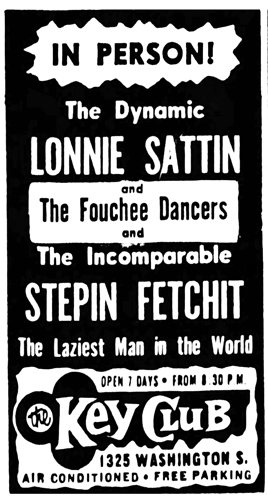
Minneapolis Tribune, July 17, 1959
Brook Benton, July 27-August 2, 1959
Bobby Freeman appeared at the Club from August 10 to 16, 1959. Freeman was known for his hit, “The Swim.” Also on the bill were the the dance team the Three Leggers (back for a second stint at the Club, the McCoy Sisters, and the Pete Digges Band.
Ink Spots, August 17-30, 1959
Sammy Turner, with Doris Hines, August 31-September 6, 1959
Steve Gibson and the Red Caps – as seen on Ed Sullivan, Jackie Gleason, and Arthur Godfrey, September 7 to 21, 1959
Anita O’Day was scheduled for September 20 to 27, 1959, but she got sick in New York and missed her opening night. She showed up for the rest of the run, heading up an all-star revue called the Flamingo show. Charles Hanna of the Minneapolis Tribune reported that it was her first performance in Minneapolis; she had appeared in St. Paul in 1948 and 1949.
Will Jones wrote that she looked “bright and little-girlish in a demure blue dress with white lace collar and little white gloves.” He also reported that:
She wouldn’t trust her pipes to the backing of the rock ‘n’ roll house band, so he’s singing up her cool little storms with the backing of a borrowed band (the house group from Herb’s who aren’t working while The Three Sounds are at that place.)
Besides Miss O’Day, the Key Club this week imported a new packaged show that includes a 63-year-old stripper billed only as Caledonia, and a line of 4-girls-4. During my visit there, the girls performed a sadistic little number in which they dance with torches and apply them to the epidermis of a male dancer who appears as an unfortunate citizen who gets washed up on the amazons’ beach. How the guy keeps from getting cooked is his secret. (Tribune, September 24, 1959)
Nellie Lutcher, September 28 to October 11, 1959
Singing star Roy Hamilton appeared on October 12 to 18, 1959. Also on the bill were the Flamingo Dancers, vocalist Doris Hines, and the Larry Wrice Combo.
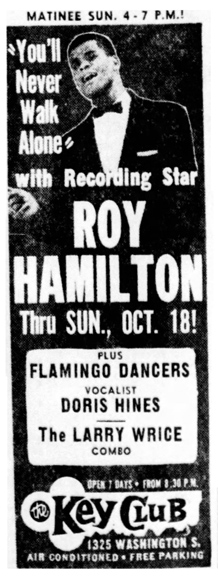
Minneapolis Star, October 16, 1959
Hammond organ stylist and pianist Bill Doggett appeared on October 19-25, 1959. His big hit was “Honky Tonk, Parts I and II.” Local singer Doris Hines joined him, as well as comic Dave Turner and singer Val Martinez.
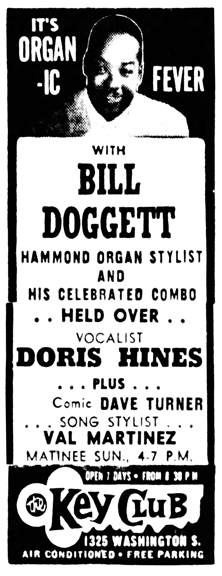
Minneapolis Star, October 23, 1959
Gloria Smyth, November 2-15, 1959
The Key Club continued with its major musical acts, although performer Christine Jorgensen was known more for her Danish sex change operation than her stage show. She was paid $2,000 for her appearance, from December 25, 1959 to January 3, 1960. Near the end of her act, she sang “I Enjoy Being a Girl.”
1960
Illinois Jacquet, January 4, 1960
Etta James graced the stage of the Key Club in February, 1960. Miss James was famous for numerous R&B hits, including “The Wallflower” (a/k/a “Dance With me Henry”) and the quintessential version of the 1941 song “At Last.” Also on the bill were the Dancing McCoy Sisters, a contortionist called the Great Bender, and Pete Gentry’s Band.
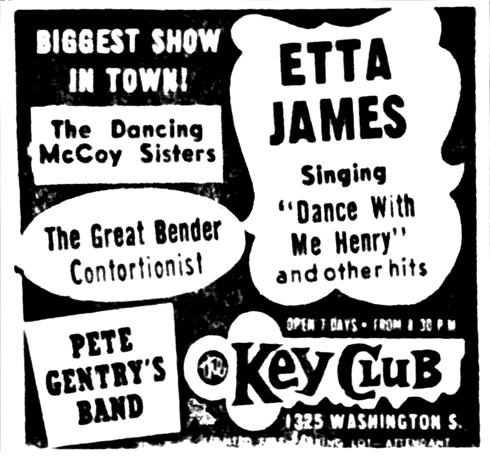
Minneapolis Star, February 1, 1960
Billy Eckstine appeared at the Key Club from February 26 until March 6, 1960. Sabes, along with various other businessmen offered the NAACP one half of the proceeds from Eckstine’s 10-day run to be used in hosting the group’s national convention in the Twin Cities that June. (Minneapolis Star, February 23, 1960)
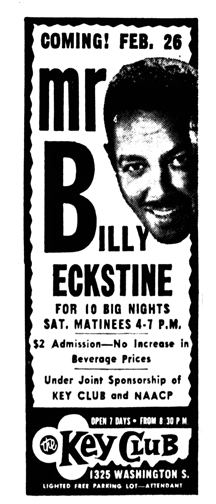
Minneapolis Tribune, February 1960
The Flamingos – March 28, 1960
Step Brothers, April 15, 1960
Dakota Staton, April 22, 1960
Cle’a Bradford was the a jazz singer from Chicago, appearing from May 2 to 8, 1960. Will Jones wrote that he often enjoyed lesser-known names better, as a couple of the “well-paid ladies” who had appeared at the Club recently appeared to be “audience haters.” Miss Bradford had an apparent liking for her audiences.
Jones also wrote that audiences were likely to bbe offered a nibble of free Vescio’s pizza, which had opened as a new room in the club. At slow times, cook John Evangelist “whomps up a big pizza and sends it over into the show room to be passed around” to lure new customers. Jones recommended the bracioli (stuffed beef), a specialty at the Dinkytown Vescio’s. (Tribune, May 6, 1960)
Chris Connor and Her Trio, May 13, 1960
Frankie Lymon, still only 18 years old, appeared at the Key Club on May 25, 1960. The bill also included singers Elizabeth Lands and Tommy Brown, and dance and mimic team Turner & Johnson. Horace Henderson was the house bandleader.
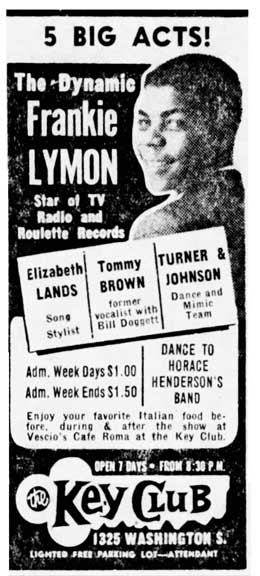
Minneapolis Tribune, May 25, 1960
Loray White (Sammy Davis, Jr.’s ex-wife), June 6, 1960
Cab Calloway his own self appeared on June 20, 1960. Horace Henderson led the house band.
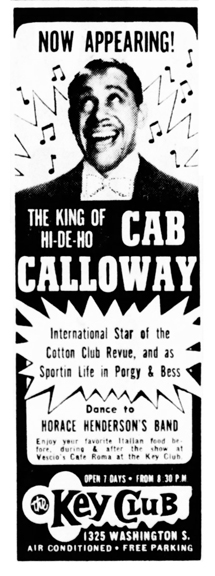
Minneapolis Star, June 20, 1960
Redd Foxx, “The Funniest Man in the World,” appeared at the Key Club on July 7, 1960. Also featured were Lorez Alexandria, and exotic dancer Ann Inga.

Minneapolis Star, July 7, 1960
The Hortense Allen Revue led the bill from September 12, 1960, to the end of October. Also on the bill was “Mr. Emotion” Bunny Sigler, who could imitate Ray Charles. Song stylist Clea Bradford entertained, and Count Belcher provided dance music.
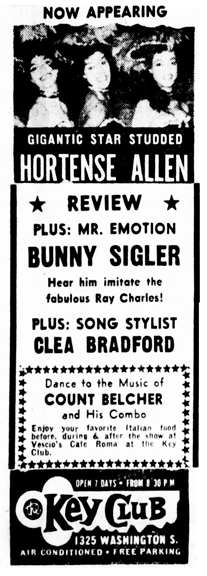
Minneapolis Star, October 21, 1960
The Treniers, October 1960
Perri Lee (Blackwell) was a jazz organist and pianist, who, as the ad says, sang a duet with Doris Day in a nightclub scene in the movie “Pillow Talk.” Also on the bill was vocalist Vi Jefferson. Doughty’s Pit Smoked Bar-B-Que was on the menu.
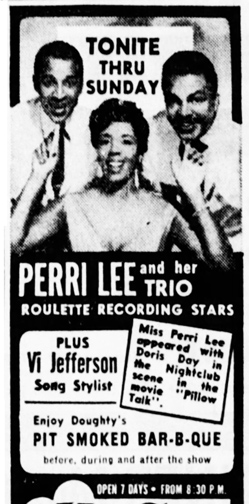
Minneapolis Star, November 11, 1960
1961
Roy Milton featuring Mickey Champion, blues and ballad singer, January 19, 1961
Ink Spots Revue, featuring Bill Josephs and Daisy Banke, March 15, 1961
BIG NAMES OUT
Apparently the Big Name Policy took a vacation in the spring of 1961. The ad below from April 6 features the Gene (Bow Legs) Miller Band, Comedian and M.C. Johnny Q. Nut, and exotic dancers Hana Chan and Alicia McNeil. Doughty’s Pit Smoked Bar-B-Que was on the menu.
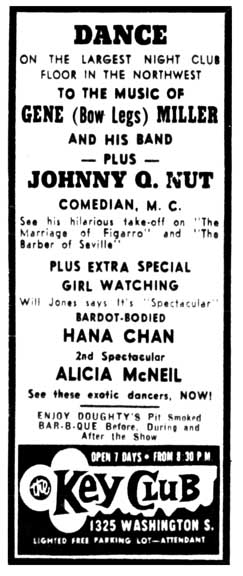
Minneapolis Tribune, April 6, 1961
THE HOCKETT SHOOTING
On April 14, 1961, Sabes shot two patrons, one on purpose and one by accident. Both survived. Richard Hockett, age 30, wanted to take his drink out into the street at closing time, and when told that this was illegal, he smashed his glass on the floor. He was tossed out by the cook and the floorman, and five minutes later he came back with a gun that he pointed at the floorman and Sabes.
Two detectives happened to be in the Club on a routine check, but before they could react, Sabes shot Hockett, who ended up with a bullet lodged at the base of his skull. Also wounded was bystander Cecil W. Carter, age 35, who was struck by a stray bullet and suffered a skull fracture. Hockett denied having a gun, but a pistol was found on a coat room shelf. It turned out that Hockett’s gun was rigged so that it could shoot all seven bullets at once, potentially firing “like a machine gun.”
Sabes was not arrested but the Hennepin County Attorney insisted that the Mayor or the Chief of Police sign a complaint charging Sabes for first degree assault. When no member of the police force would sign the complaint, the County Attorney dropped the charge. At the time the police called the place “a known hangout for criminals, and detectives regularly check the place.” (Minneapolis Star, April 14, 1961)
Although the police and Hockett refused to press charges, wounded bystander Carter filed first degree assault charges against Sabes on April 25, 1961. Bail was set at $3,000 but Sabes was released on his own recognizance. A hearing was held before a judge, and the charge was thrown out on May 8, 1961. The deciding factor was Hockett’s gun, rigged to fire seven bullets at a time. The judge said that although Sabes’ action was drastic, it turned out that “it surely prevented seven imminent potential murders.” (Minneapolis Star, May 8, 1961)
The Hortense Allen Review provided entertainment in April 1961, along with vocalist Mildred Anderson. Gene (Bow Legs) Miller continued as house bandleader.
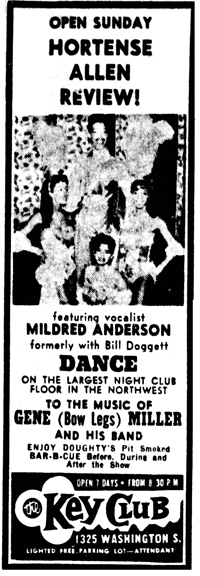
Minneapolis Star, April 28, 1961
Will Jones reported on May 25, 1961, that given the bad publicity the club was getting, Sabes was thinking of changing the format to Country. Road Buddies was taking over a room in the Key Club, and trying out a C&W policy, starting with Chuck Carson’s band on June 1, 1961.
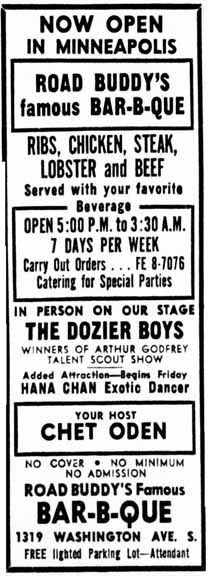
Minneapolis Tribune, Wed__Jun_14__1961
The fabulous Dozier Boys came to the Key Club on September 1, 1961. Augmenting the bill was the lovely Doris Hines. Chet Oden’s Road Buddy’s Bar-B-Q was available.

Minneapolis Tribune, September 1, 1961
HERB KLEIN
The ad below announces that Herb Klein was now the host of the Key Club. Not sure if that meant he was the permanent MC or the General Manager. Klein was a brother-in-law of Sabes, and had opened his own club, Herb’s, at 324 Marquette Ave. in Minneapolis in 1946. That building was torn down in 1961 for the Gateway Clearance project, which is when Klein came to the Key Club. Klein opened a second iteration of Herb’s at 654 Second Ave. No. at Glenwood Ave. in late 1963.
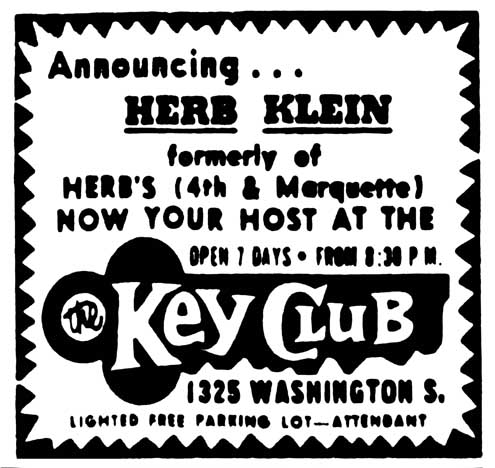
Minneapolis Star, September 20, 1961
The ad below from October 1961 features singer Laura Johnson, but the Dozier Boys were the big act on the bill, either back or held over from September. Filling the card were MC, comedian, and dancer Cadillac Willie and exotic dancer Kahlua. Chet Oden’s Road Buddy’s Bar-B-Q was available. What a night!
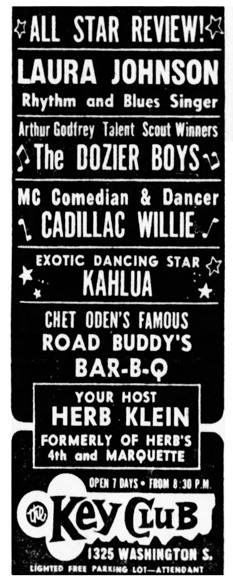
Minneapolis Tribune, October 28, 1961
Earl Bostic made a return engagement from November 10 to 19, 1961. The club was served by Chet Oden’s Road Buddy’s Bar-B-Q.
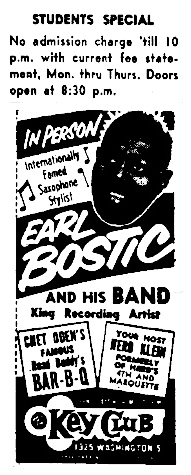
Minnesota Daily, November 10, 1961. Ad courtesy Robb Henry
The Key Club instituted a scantily-clad waitress policy with a twist – all of its waitresses were black. Juanita Green was the first to don the new costume and model it in Will Jones’s column. It was not racy by our standards at all.
The International Jazzmen entertained for four nights, on November 20 to 23, 1961. The band featured Eddie (Exodus) Harris and Jay Peters on battling saxes
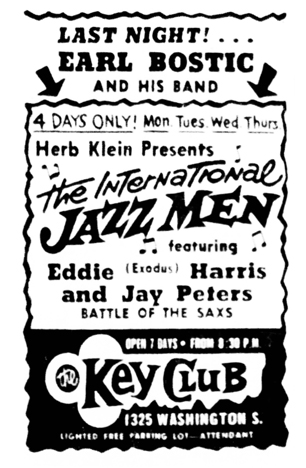
Minneapolis Tribune, November 19, 1961
The Flamingos were in the Club from November 24 to December 3, 1961.
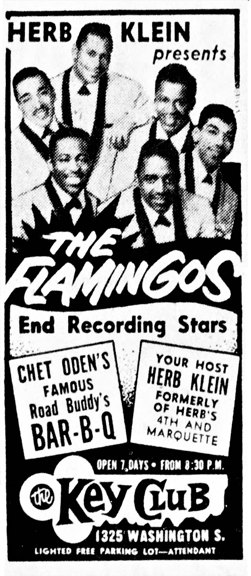
Minneapolis Star, December 1, 1961
BILL DOGGETT AND THE TWIST
Bill Doggett returned for an extended engagement, from December 4 to 17, 1961. This may have been the first reference to the Twist, which really took off in 1962.
The Twist was hot and in December 1961 the Key Club offered Twist lessons to its patrons. Will Jones reported on December 18 that:
It was a wild, wild night at the Key Club. Bill Doggett’s twist music proved so infectious, one woman patron jumped onstage and began to strip which isn’t exactly the idea. The management hustled her off.
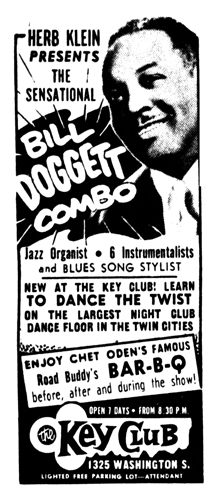
Minneapolis Star, December 16, 1961
The Hortense Allen Dancers came to teach the Key Clubbers to do the “controversial” twist, to the music of the Bill Pinkard Trio and blues singer Harold Connors, formerly with B.B. King. This lineup probably began on December 18, and was described as an unlimited engagement by the Minneapolis Spokesman. (December 22, 1961)
1962
On January 30, 1962, Will Jones reported that the socialites and suburbanites had discovered the Key Club and invaded the place on weekend nights to be taught the dance by “those wild, wild” Hortense Allen Dancers.
Variations of this ad appeared throughout 1962. This particular one below appeared on March 24, 1962.
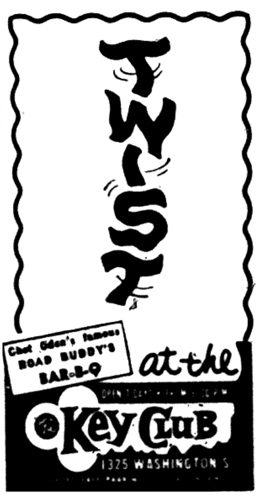
In mid-1962 the Minneapolis Star and Tribune went on strike, and the slack was taken up by a Minneapolis businessman who put together the Minneapolis Daily Herald. On June 22, 1962, the Herald published an ad for the Key Club, promising to teach all comers to do the Twist. The show starred Comedian-MC Sandman Howard and the Beautiful Key Club Twisters, and Chet Oden’s famous Road Buddy’s Bar-B-Q was available.
On July 30, 1962, an ad in the Herald showed that the new Comedian-MC was Leroy Watts, and music was provided by Count Belcher and His Band. A picture was provided of two of the beautiful Key Club Twisters, but the microfilm doesn’t translate well. “Everybody Twists at the Key Club.”
On August 1, 1962, Vic Burton’s Night Beat column in the Herald described the Key Club’s Twist show, emceed by Leroy Watts. There were three women who demonstrated the dance: Helena DeCarlo, Penny Wallace, and Watts’s daughter, Cyoreta. Helena does an added fire dance. They also got the audience up on the floor; Watts said that they teach the twist to more than 600 people each week, and one night they had 200 beginning twisters on the dance floor at one time. Some speculated that it was just a fad, but others gave it at least three years. To mix it up, there were other new dances, such as the Popeye, the South Street, the Loca-Motion, the Stair, the Watusie, and “several other jazzed-up versions.” “But whatever the twist is, if Jackie Kennedy does it – it can’t be all bad.”
In September 1962, Herald reporter Bob White wrote about the act Pete and Repeat, who were starring in the stage show, and who had appeared at the Club before in August 1958.
These two talented fellows must wear out a set of taps each night with their exciting dance routines. They must wear themselves out with their sensational splits, spinarounds, flipovers, and knee bends. These boys are headed for the top.
Performing with Pete and Repeat was Leroy Watson, M.C. and dancer, who was twice their age but executed some of the same difficult steps and stunts as the younger dancers. Watts injected showmanship into acts of ordinary talent. White noted that Mrs Watson made all the costumes for the act, which included a “technicolor costume dance” called “Night in Tunisia” featuring Penny and Cyoreta. He described the act as “every bit as fascinating as an act at the Lido in Paris or the Copa in New York.” Count Belcher’s band provided music for the show and for dancing – mostly twist music. (Minneapolis Daily Herald, September 12, 1962)
THE END, PART I
On September 26, 1962, the Minneapolis City Council License Committee ordered police and health department reports on the South of the Border Bar, the Key Club, and the Old Southern Barbeque, which had been called “known hangouts for narcotic addicts and prostitutes.” The accusations were made at a Federal District Court trial by a former head of the police morals squad. The Committee also asked the City Health Department to report on venereal disease contacts in the three locations. (Tribune, September 27, 1962)
A series of hearing were held, at which police officers testified that 89 arrests were made since 1958 because of activities of prostitutes in the South of the Border and the Key Club.
Sabes offered to close the bar if he could keep the Key Club open. Then he proposed moving the bar to a better neighborhood and turning it into a supper club. Then he tearfully asked the City to allow him to sell the bar and get his investment out of it. (Citation unclear – perhaps Minneapolis Spokesman)
On November 20, 1962, the requested report of prostitute contacts at the South of the Border Bar were read into the record, and the Key Club did not look so good. (Minneapolis Star, November 20, 1962)
After these hearings, the City Council revoked his food, liquor, and entertainment licenses on November 23, 1962. (Minneapolis Tribune, March 23, 1963)
CECIL E. NEWMAN
Sabes found support in Cecil E. Newman, editor of the Minneapolis Spokesman, who pointed out, in a letter to the editor to the Minneapolis Tribune, that the Key Club was the first night club in Minneapolis to break the color line against black artists and provided the best in contemporary jazz music and entertainment. It was one of only a few establishments that hired black musicians, bartenders, waitresses, floormen, and maintenance people. He pointed out that it had 17 permanent black heads of families with 23 dependents. Newman called it “The first night club in Minneapolis to break the color bar against Negro artists in night clubs.” Plus it was one of the few places black patrons could go and feel welcome. Newman had been to almost ever club in town, but often had been the only black person there.
He felt that the Key Club and South of the Border were being held responsible for events that happened blocks away from the clubs, and that the “social misfits” of narcotics addicts and prostitutes hang out in a large number of places in Minneapolis. (Minneapolis Tribune, December 12, 1962)
Sabes filed an appeal to the Minnesota State Supreme Court, which allowed him to stay open until that court rendered a final decision.
1963
The ad below from January 1963 declared the Key Club “Now Open!” The club was only open three nights a week. This time the music featured the Bossa Nova instead of the Twist.
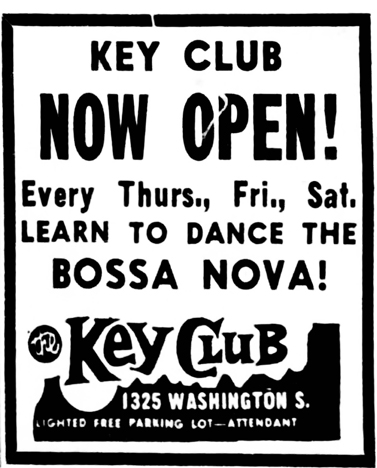
Minneapolis Star, January 31, 1963
From February 7 to 14, 1963, the Bardettes provided the music, featuring vocalist Charles Singleton. Also entertaining were the Harlemet Dancers.
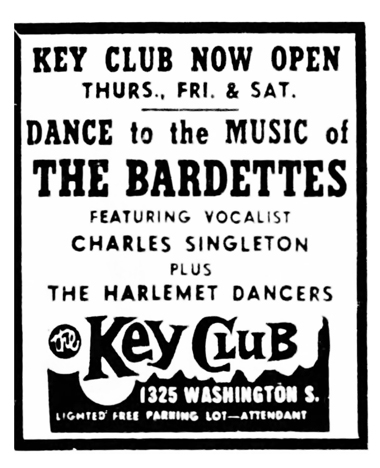
Minneapolis Star, February 7, 1963
Dakota Staton turned out to be the last act of the original Key Club, performing from March 11 to 17, 1963. In his column of March 13, 1963, Will Jones commented that the club’s “showmanly gambit of booking jazz names in the face of its legal troubles is paying off. Dakota Staton has brought some life back to the club, once thought dead.”
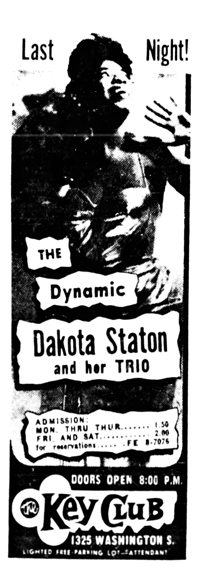
Minneapolis Tribune, March 16, 1963
THE END, PART II
On March 22, 1963, the Minnesota Supreme Court upheld the Minneapolis City Council’s revocation of Sabe’s food, liquor, and entertainment licenses in a 6 to 1 decision. The decision said that Sabes was charged only with knowing that prostitutes were frequenting his establishment and that numerous convictions resulted from the acts of prostitutes who solicited on his premises. Further proof was not required to sustain the revocation of his licenses. “No citizen has an inherent or vested right to sell liquor, and municipal authorities have broad discretion to determine the manner in which a license shall be issued, regulated, or revoked.” The decision also said that a bar operator was responsible for conduct on his premises, and that Sabes was violating state law by permitting his club to be used as a hangout for prostitutes.
Sabes told the Court that he had invested fore than $160,000 in the business and that its value was more than $200,000. Club Manager Mel Bellman testified that he and seven other employees would lose their jobs, including four bartenders, one waitress, and one porter – more employees had been let go after the City Council had revoked the licenses.
Sabes voluntarily closed the clubs on March 22; the licenses would have expired on March 31, 1963. (Minneapolis Tribune, March 23, 1963)
Now a pause for some background on the successor to the Key Club:
FRANK SEIFERT AND THE INN-TUITION CLUB
1429 Washington Ave. So.
The building that was the home of the original Inn-Tuition Club had been the home to the Seventh Corner Bar since the late 1938s.
In May 1961, the Seventh Corner Bar had been involved in the Purity Soap scandal, in which Minneapolis Alderman Romeo Riley, who was on the committee that awarded liquor licenses, sold soap to several bars. Somehow Kid Cann was involved. At the least it was a conflict of interest.
The only other mention of the Seventh Corner Bar was the painting below, painted by Leatrice Hoover of Roosevelt High School, who won the Ingersoll State Award in the annual Scholastic magazine arts competition. The picture went on exhibit at Carnagie Institute in Pittsburgh.
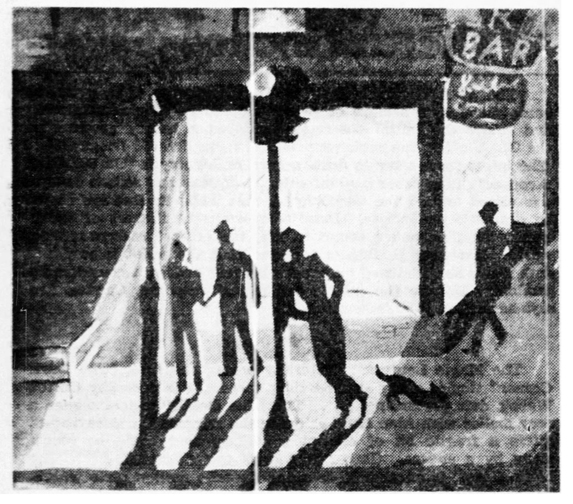
Minneapolis Tribune, May 19, 1946
The Inn-Tuition
On October 14, 1961, Frank Seifert opened the Inn-Tuition Club. Seifert was an announcer at WTCN-TV.
To prepare the long narrow space for his new club, Seifert built a wood frame balcony on the second floor, and took out the front glass window and closed it up. His first act was a fellow WTCN employee, Don Marlowe, who did comedy. He hired jazz trios to perform between sets. Entertainers performed on the balcony.
Besides being the Year of the Twist, 1962 was also the Year of the key club. A key club (lower case) was open to those who paid a membership and met certain criteria. At the Inn-Tuition, memberships were $10 (presumably per year?), drinks were cheap, and members had to be
- unmarried
- employed
- 21 or over
Seifert advertised that he would open as a key club in March 1962, but demand was so high for memberships (especially women) that he shut down on April 7 and reopened under the new structure on April 23, 1962.
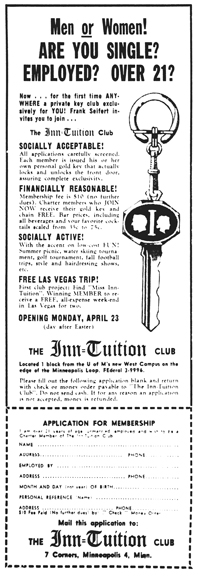
Minneapolis Tribune, March 30, 1962
Vic Burton, writing for the Minneapolis Daily Herald, seemed to have a good point when he wrote that that the best way to make money in the Minneapolis bar business is to keep most people out. He noted that the Inn-Tuition now had rules that ruled out about 99 percent of the population. He wondered how one went about proving he was single – it was one thing to prove you were married, but the opposite? He did like that the singers at the piano bar sang softly. An open house was scheduled for May 5, 1962. (May 3, 1962)
Vic Burton’s column of August 6, 1962, revealed that Frank Seifert realized that the Key Club of old, with big name entertainment, was on its way out, because people could see the stars on television for free and didn’t have to go to a nightclub anymore. So he had to offer service and exclusiveness as a substitute for the big names. (Minneapolis Daily Herald)
MOVING TO THE KEY CLUB
Seifert quit his other job at WTCN in November 1962, and stated his intention to move to a warmer climate due to chronic bronchitis. But when the (upper case) Key Club closed on March 22, 1963, he set his sights on that, looking to expand even further. On March 29, 1963, he applied to move his liquor license from 1429 Washington Ave. So. to 1327-29 Washington Ave. So.
After delaying action seven times, the City Council approved his application on July 26, 1963. Seifert rented the Key Club building from Sabes for $800/month. Members of Seifer’s old Inn-Tuition Club would have exclusive use of South of the Border, and the former Key Club would become known as Frank Seifert’s.
FRANK SEIFERT’S
Frank Seifert’s opened on August 9, 1963. He had two house bands: the Key Noters played Bossa Nova, Fox Trot, Waltz, Mambo, and Cha Cha, while Augie Garcia covered Rhythm & Blues, Twist, Surfing Rhythms, and Jazz. The large dance room was open to the public for $1 admission charge.
When revealing his plans to Will Jones for the club, Seifert said he wanted no intermissions, and an atmosphere “like a small town on a Saturday night. Every night.” Dudley Riggs would operate the food concession, which was to include steak and eggs, fish and chips, small steaks, marinated bourbonburgers, and a salad cart. Riggs would not offer any of the fancy coffees or pastries featured at his separate Cafe Espresso. (Tribune, July 29, 1963)
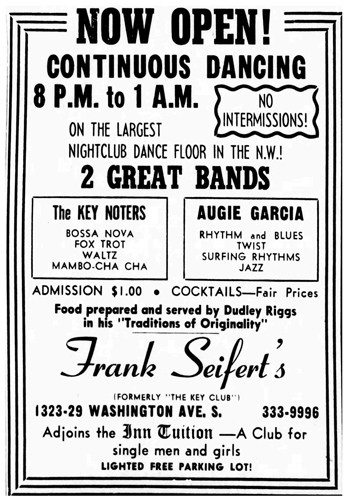
Minneapolis Star, August 9, 1963
Ads like the one above ran through August 1963 but stopped.
Will Jones complained that “the combination of Augie Garcia’s band and the old Key Club sound system adds up to so many decibels that life in the dance-hall part of Frank Seifert’s is unbearable… I’ll take some engineering.” But he found the Inn-Tuition bar was quiet and pleasant, and was more than pleased with the food service. (Minneapolis Tribune, August 19, 1963)
NAME ACTS
On October 1, 1963, Will Jones noted in his column in the Tribune that Frank Seifert’s had reverted to a show room with name acts. Ronnie Newman’s Keynoters stayed on as the house band. The first big name was Lisa Carroll, who began her run on October 5, 1963, according to the ad below. (Jones said Friday night, which would have been October 4.) According to Jones and the ad, Carroll appeared on the Steve Allen Show on October 2, 1963. On the same bill with Carroll was a duo called the Kay-Eds.
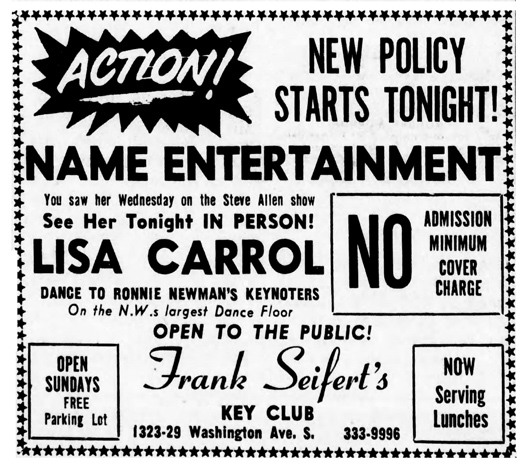
Minneapolis Star, October 5, 1963
On Friday, October 11, 1963, singer Molly Bee was scheduled to appear for a week, according to Will Jones.
1964
BACK TO THE KEY CLUB
This name change did not last long. By the first anniversary, the club was still being run by Seifert, but it was back to being called the Key Club. With few exceptions, the entertainment was provided by Mojo Buford and His Chi 4. In 1964 they were still playing Rhythm & Blues.
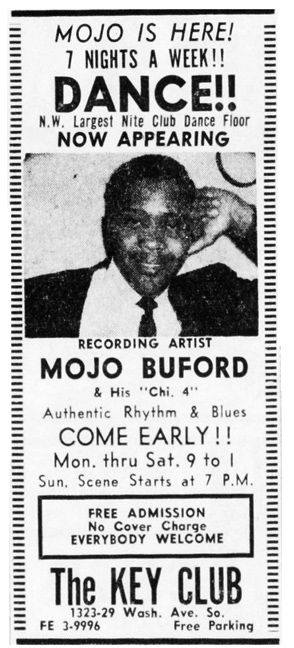
Minneapolis Star, May 8, 1964
A telling column from our friend Will Jones on July 1, 1964:
After a long dry spell, things are swinging once more at the Key Club. In addition to the Wednesday dance contests, Seifert is starting other special nights this week. Thursday it’ll be talent night, and he has worked out an arrangement to turn over the $1 admission charges to the NAACP to help pay fines for civil rights workers in Mississippi and Florida.
A bikini beach party will be the Saturday attraction, with everybody invited to turn up in bikinis and compete. Seifert says he’s keeping his fingers crossed on the matter of topless bathing suits, but he won’t say what he’s wishing when he crosses his fingers. Nest Monday he starts a celebrity night.
“Mr. Personality,” Bob Ross, formerly with the Ink Spots, appeared with Mojo for a limited engagement at the end of October 1964.
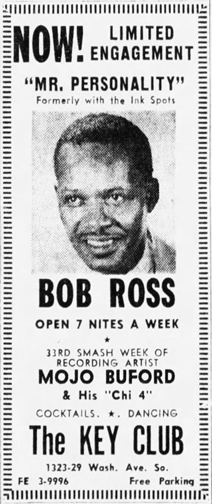
Minneapolis Tribune, October 30, 1964
1965
Mojo Buford was a blues artist, but if the people wanted “discotheque dances,” you go with the flow. And 1965 was definitely the year of the Go-Go! Contests for such dances were held on Mondays, Tuesdays, and Wednesdays. On Thursdays there were Talent Contests, promising Beautiful Prizes. 1965 was the second year that Mojo Buford and His Chi 4 did their duties as the house band.
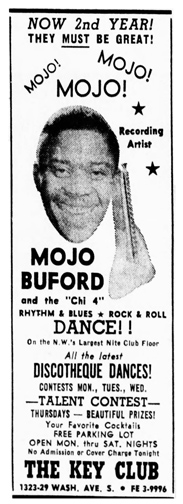
Minneapolis Star, May 24, 1965
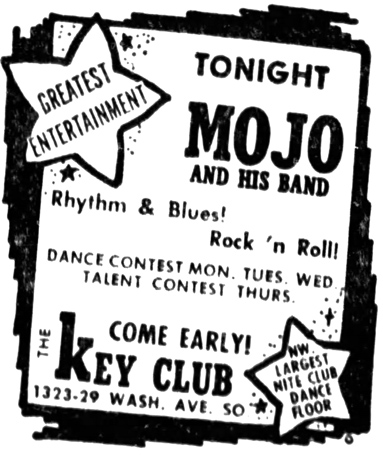
Minneapolis Tribune, June 25, 1965
From July 19 to 25, 1965, Chicago blues guitarist Earl Hooker paid a trip to the Key Club. Hooker was a cousin of the better-known John Lee Hooker. Given the tenor of the day, his band was called the Rockin’ Soul Twisters, featuring Lee Shot Williams and A. C. Reed. Hooker and Mojo Buford carried out a Battle of the Bands for Hooker’s one week stay.
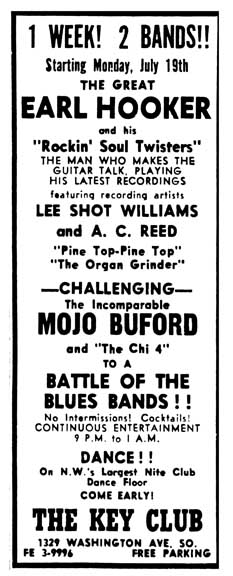
Minneapolis Tribune, July 15, 1965
Legendary bluesman Muddy Waters came to the Club on July 26, 1965, and was present for the Ike and Tina show on August 2. He and his Band were held over until August 5.
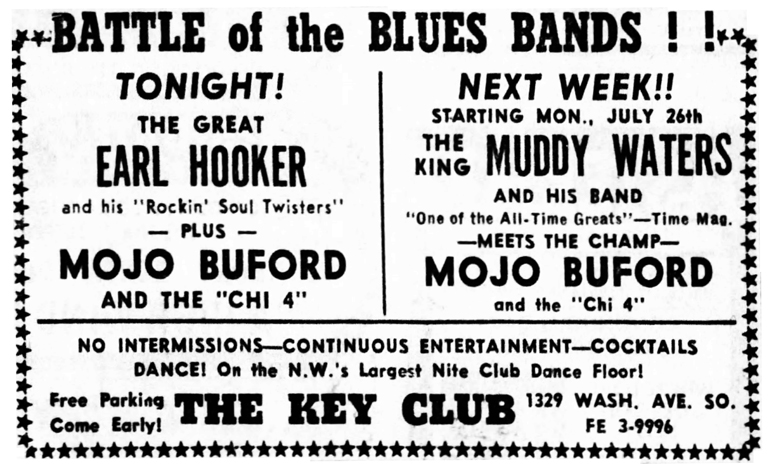
Minneapolis Star, July 22, 1965
The Key Club went out with a bang, with a show by Ike and Tina Turner on August 2, 1965. On the same bill were Muddy Waters, and Mojo Buford and the Chi 4. The house must have come down!
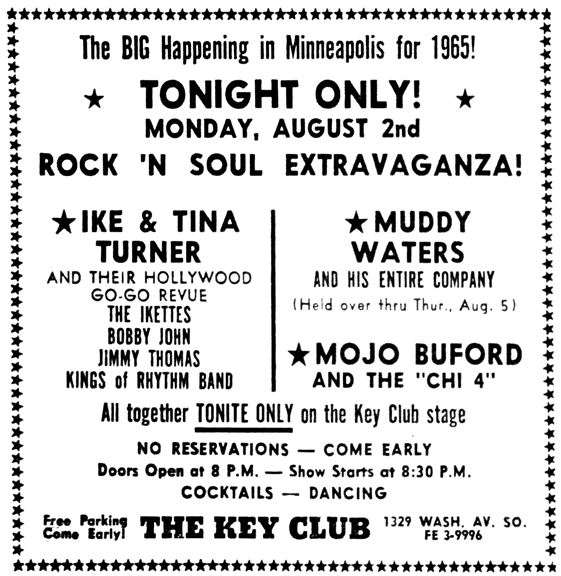
Minneapolis Tribune, August 2, 1965
It was a full card opening on August 23, 1965, starting with the Paul Weston Quartet featuring Saundi Taylor, “The Golden Go-Go Girl,” “Direct from ‘Shindig.” Except that there is nobody by those names associated with “Shindig” that can be found on Ye Olde Internet. Hmmm….
The regular house band, Mojo Buford and The Chi 4, was also on hand to make sure there were no intermissions.
And starting tonight was the San Francisco Go-Go Review, “The Most Beautiful Go-Go Girls This Side of Las Vegas.” Will Jones called it the San Francisco Topless Review in his August 22, 1965 column.
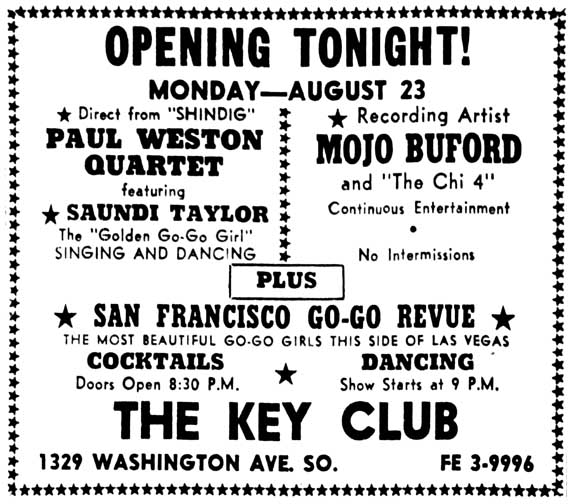
Minneapolis Star, August 23, 1965
On September 1, 1965, only Saundi Talor (was that a typo?) was in the ad.
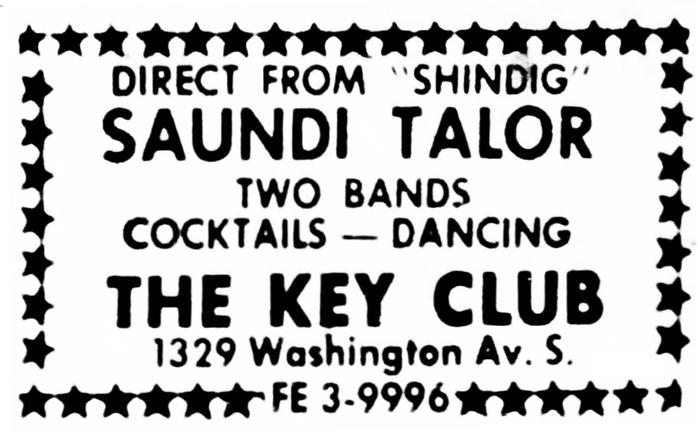
Minneapolis Tribune, September 1, 1965
And finally, Mojo closes out the Key Club with the “Biggest Go-Go Show in Town” with Go-Go Girls and dancing. Thanks, Mojo.
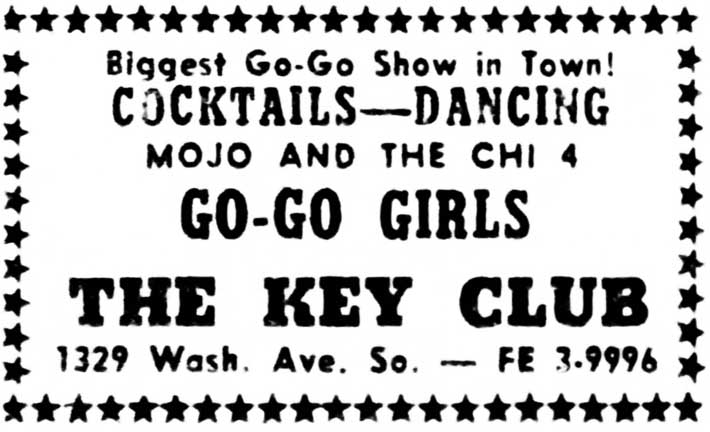
Minneapolis Tribune, October 9, 1965
The building was demolished in 1966 and appears to be in the middle of 35W.
Save
Save
Save
The Keystone Bar was first located at 644 Sixth Ave. No., until that building was wrecked in 1939. It then moved to the first floor of the Kistler Building until that building was wrecked in 1957. Please see the Kistler Building for more on this bar.
379 Carroll Ave., St. Paul, 1935. Dine and Dance Once Again at the Autumn Leaf Dining Room. Dancing every night, Special Cabaret Nights. C.F. Williams, Proprietor
The King Cole Hotel was located at 60 Willow Street at Yale Place, overlooking Loring Park.
LORING PARK CLINIC
The eight-story building was originally planned to be the Loring Park Clinic, housing a hospital, sanitarium, and medical clinic. The Loring Park Clinic was founded in 1911, in 1923 it was located in a three story, 32-room mansion at either 1508 or 1600 Harmon Place. It specialized in kidney stones, gallstones, and selling tea for weight reduction. The new building was meant to replace the crowded building, and it appears that shares were sold and court cases were filed.
NORDIC HOTEL
Next the Nordic Hotel Association, Inc., was formed to turn the building into a hotel. Construction was started in 1922, but for eight years the concrete skeleton stood without walls.
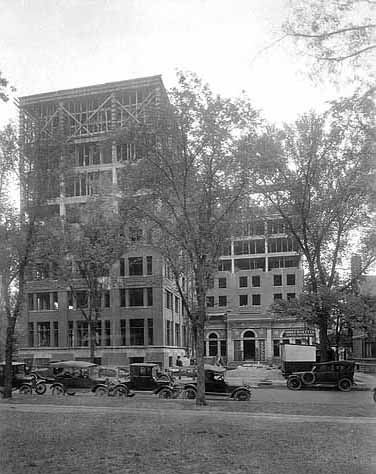
This MHS photo is from 1925.
A headline reads “Work Speeded on New Nordic Hotel.” (Minneapolis Tribune, March 16, 1930). It was finished in late 1930, and the Association planned to furnish, equip, and operate it as a memorial to Norwegian-American pioneers. The building was completed except for the furnishings when the Association ran out of money, and went into foreclosure in 1931.
KING COLE HOTEL
In October 1934 the building was purchased by Peppard Properties, Inc. The new owner conducted a contest for a name and King Cole was chosen when the hotel opened on December 1, 1934. (Minneapolis Star, January 24, 1949).
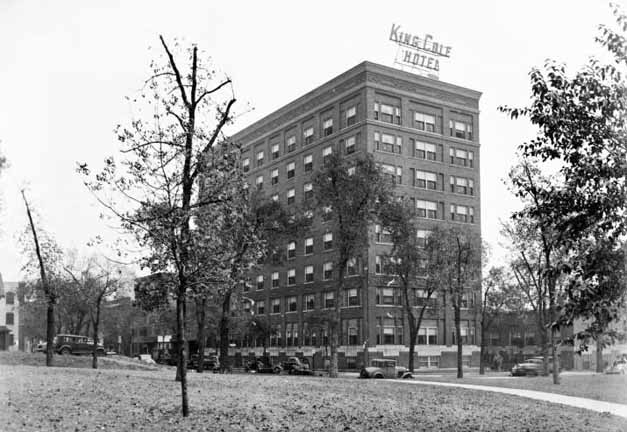
1935 photo courtesy Hennepin County Library
However, a search of the Minneapolis papers finds a mention the King Cole Hotel on February 13, 1926. A different King Cole Hotel? Must be an anomaly, since the next mentions don’t start until January 1935.
Cedar Imboden Phillips has described it as “a destination for countless local celebrations and special events,” presumably with music involved. The social columns noted that guests to town stayed at the hotel; notorious guests included Bugsy Siegel, according to Phillips. Meetings were held there, and in the mid-1930s more dances began to be held at the hotel. These were all private affairs, sponsored by such groups as the Hanky Panky Club, an organization of magicians. Other common events were wedding receptions, class reunions, fraternity and sorority dances, etc.
In 1935, the murder of journalist Arthur Liggett spurred several police investigations. One was by the “Secret Six,” a group out of Chicago, headquartered at the King Cole Hotel. (Minneapolis Star, December 11, 1935)
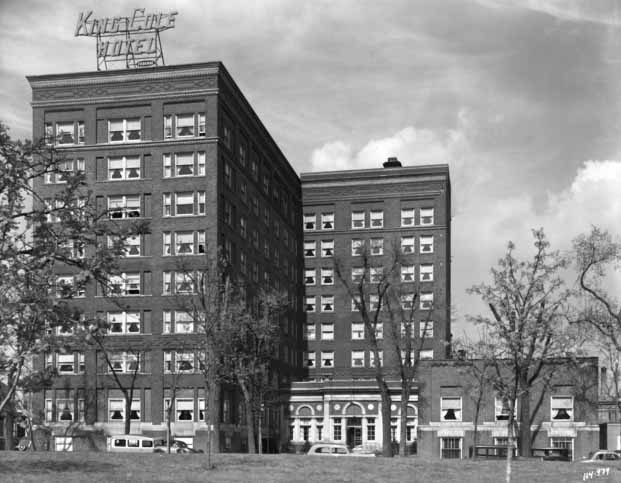
May 12, 1936 photo courtesy Minnesota Historical Society
In 1937 advertisements began to appear, telling us that the hotel had a swimming pool, “physical culture studio,” and a famous dining room. The hotel made much of its pool, offering swimming lessons.
In 1949 the building was purchased by the Salvation Army, which converted it into the Evangeline Residence for Girls, a residence for women between the ages of 17 and 35. Weekly rates started at $14 per week.
The building was wrecked in 1976 and replaced by Booth Manor, a senior high-rise also owned by the Salvation Army.
The King Kong Club, on the 700 block of No. Lyndale was a converted store. It had a five piece band led by Johnny Wheeler on trumpet.
The King of Clubs was located at 957 Central Ave. NE in Minneapolis.
THE BUILDING
955-61 Central Ave. NE was built in 1891 as a 24 x 60 store and dwelling, according to city permit cards. In 1900, a 32 x 32 pool room was added. In 1909 it was a saloon (or maybe it was all along) and in 1937 it was referred to as a cafe. Not much comes up in an address search.
KING OF CLUBS
Stan Murzyn was the owner from 1967 to 1980.
The bar was not really known as a music venue, but maybe it was?
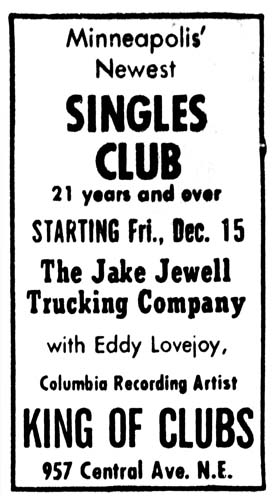
Minneapolis Star, 1972
In June 1974, the owners were identified as Edwin Schonnesen and Roger Nofstad.
In 1984 the owner was Dick L. Carlson. He died in 1994.
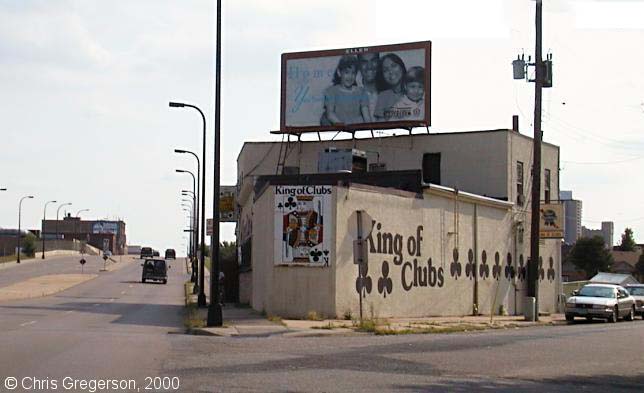
Photo by Chris Gregerson, 2000
The bar closed before 2002.
This King of Clubs was in Downtown Minneapolis for a wee bit in 1947. Please see Vanity Dance Hall.
Please See Foshay Tower
717 Hennepin Ave., had a talent contest every Tuesday night in 1952, if that counts.
The King’s Inn, in St. Louis Park, grew out of the Lilac Lanes Cafe.
On June 4, 1949, the Minneapolis Spokesman advertised the opening of King’s Valley, reached by taking US Highway 169 and County Road 1. Patrons could take one of 12 limousines leaving from two locations including Annie’s Barbeque. “Truly the Valley of the Kings.” Opening would be King Larry, His Saxophone and Quintette, with emcee E. Harry Jones.
Please see Trade Winds.
The Kistler Building was located at 633-641 Sixth Ave. No. on the southeast corner of Sixth and Lyndale. It housed a number of important jazz and R&B clubs on the North Side.
Much of this early history comes from the article “Dust of Jazz Era Rises From Ancient Building” by Don Morrison, Minneapolis Tribune, November 10, 1957.
THE BUILDING
1889
The building was originally the 17-room mansion of Doctors J.M. and Charles M. Kistler, built in 1889 at a cost of $15,000. The Kistlers attended to the Jewish population in North Minneapolis, living and working in the building. They and their families lived in two apartments on the second floor of the 50 x 90 ft red brick building. James Kistler built the building and ran a grocery store on the first floor.
Because there were three floors and so many different venues through the years, the following chronology is impossibly non-linear. But I’ve used ads and news articles as best as I could to try to put together a picture of what kinds of things were happening in this iconic building. Imagine what you could see and hear in the Kistler Building!
THIRD FLOOR
From the beginning through 1926, the third floor hall was originally rented out to various groups for lectures, meetings, dances, card parties, and even weddings. It was clearly used as a community space for various political, social, and fraternal groups in the neighborhood.
1898
For example, in 1898, the United Pleasure Club announced a series of dances to be held at Kistler’s Hall, with Hamlin’s Orchestra providing the music. “This popular organization grows steadily in public favor and its parties are always well attended.” (The Irish Standard, October 15, 1898)
ODD FELLOWS: 1899 – 1905 THIRD FLOOR
One of the original tenants of the building was the John White Lodge No. 150 of the Odd Fellows, situated on the third floor. On September 18, 1899, the Lodge gave a social reception to its members and friends in its new hall, attended by 400 people including Dr. J.M. Kistler. This might have been a dance, since a floor manager was mentioned. (Minneapolis Tribune, September 22, 1899).
The Lodge regularly gave dances, “social hops,” masquerades, and card parties. The last mention of the Lodge in the papers was in February 1905.
ATLAS CLUB – 1907 – 1918 THIRD FLOOR
This appears to be an athletic club dedicated mostly to boxing, although they did make the hall available to other groups. It was in the Kistler Building by at least 1907. The organization moved and then disappeared in the fall of 1918.
1908
EMMA GOLDMAN SPEAKS
The hall was still available for speeches, apparently. on March 27, 1908, Emma Goldman, “the diminutive apostle of anarchy,” addressed a standing room only audience at Kistler’s Hall that was expecting her to speak Yiddish. Instead, it was given in an “Hebraic readjustment of high German,” which disappointed some of the crowd. The audience was also disappointed that she was not more radical in her speech, which compared the social body to a large family where people pitched in to help each other out. This does not sound radical at all. The crowd grew restless. Her next speech would be given in English on the topic of the Emancipation of Women.
MEMORIES OF THE KISTLER BUILDING
As the building was coming down, Marie Cullen wrote down her childhood memories of it and the neighborhood and they were published in the Minneapolis Star on December 4, 1957. She remembered buying groceries at James Kistler’s store, and going up the stairs (presumably to the second floor) “where old Doctor J.M. and young Dr. Charlie held forth. The smell of Iodoform and mysterious disinfectants usually assailed our nostrils as we began to reach the top of the stairs. Dr. J.M. was so good and kind. He had a horse and buggy and would always come – night or day – and was never known to send a bill.”
1920
MASONIC LODGE, 637 Sixth Ave. No. THIRD FLOOR
In 1920 the hall was used by the Masons, their female counterpart Eastern Star, and the related Scottish Rite, as evidenced by this excerpt of the Minneapolis directory from that year, provided by Buzzy Bohn:
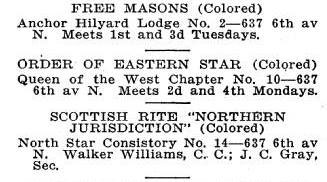
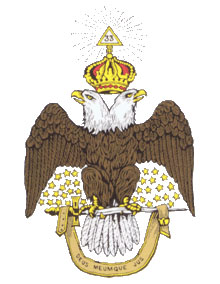
Scottish Rite Double Headed Eagle
AMES LODGE/ELKS HALL: 1921 – 1930 THIRD FLOOR
Ames Lodge No. 106, Order of Elks, Improved Benevolent Protective Order of Elks of the World. This Lodge of the IBPOE was founded in October 1906. From June 1 , 1921, to November 4, 1922, the Minnesota Daily Star referred to the third floor as the Colored Elks Hall. Dances were held three times a week and on holidays. By June 11, 1924 to at least 1925 it was called the Ames Lodge or the Elks Hall. The Elks had moved to 148 Highland by 1933. Read more about the Elks Here.
1926
In 1926, Dr. Kistler sold the building to Ben Kaplan for $45,000. The first floor was shared by the Western State bank and a pool hall, and the second floor had four five-room apartments.
APEX HALL, 635 Sixth Ave. No – 1933 – 1936 THIRD FLOOR
The Apex Club opened in the third floor, described wryly in a news story in 1932 as a place dispensing “entertainment, food, and cracked ice.” The Apex was what we now call a “black and tan” place, pretty evenly habituated by anyone who liked jazz. It was a place for after-hours jam sessions.
Just when it was open can be confusing – it would get raided, padlocked, re-open, etc. Ads tell the tale. This listing of dances may seem tedious, but maybe some descendant of one of these folks will google their ancestor and find him or her on this page. It does happen!
***PLEASE NOTE*** There were a lot of ads for the Apex in the Minneapolis Spokesman. They are all text and I would have to retype them anyway for them to be searchable. So I made the decision not to recreate them here, but just to retype them as true to the original as possible. Any ad without attribution comes from the Minneapolis Spokesman. I apologize for any personal remarks. Believe me – I would have LOVED to have gone to the Apex!
1933
The Apex Nite [Klub] opened in October 1933, and featured an “all Colored Floor Show” produced by and featuring Jimmie White, Assisted by:
- Aurora Edwards
- Jessie Scott
- Bill Pugh’s Orchestra
- The Apex Dancing Girls, direct from the Grand Terrace Cafe in Chicago
Not sure why it says formerly the P&S Chicken Shack. That’s a whole other problem left to tackle.
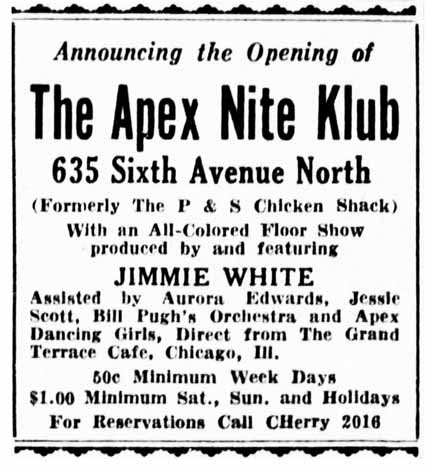
Minneapolis Tribune, October 14, 1933
The ad below from October 23, 1933, indicates that luminaries Harry Pettiford and Rook Ganz are members of the Apex Orchestra!
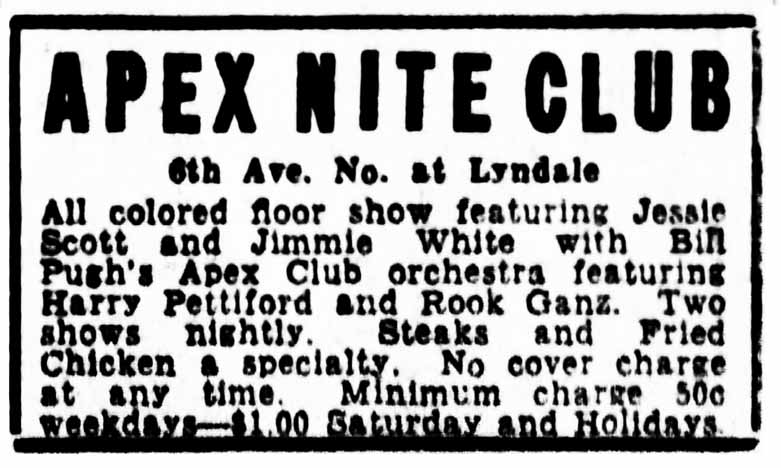
Minneapolis Tribune, October 23, 1933
December 9, 1933’s ad announces a new floor show with 12 people, direct from the Little Harlem Nite Club in Buffalo, New York. It was produced by and featured Pedro Lane, with the Rodgers and Bennie Hoofers. Not to mention a chorus of six Torrid Brown Dancing Girls. Music provided by Bill Pugh’s Orchestra.
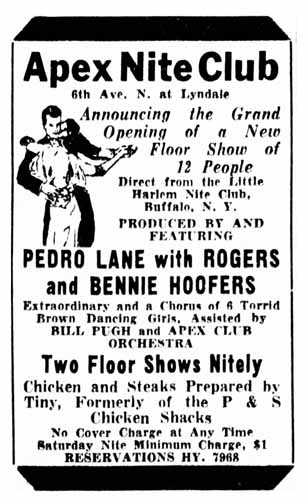
Minneapolis Star, December 9, 1933
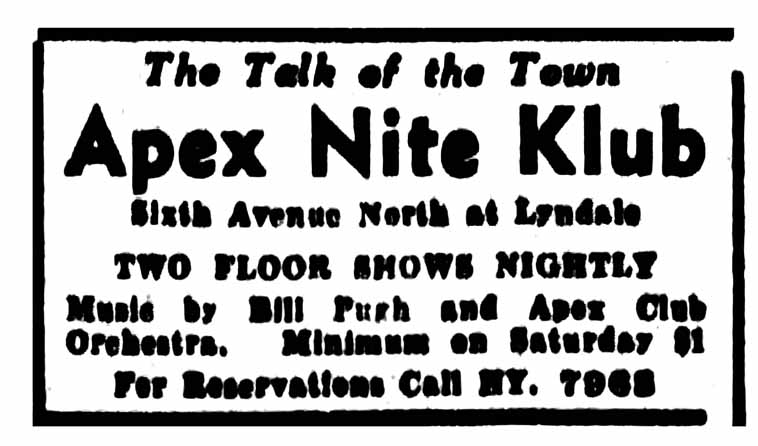
Minneapolis Tribune, December 16, 1933
1934
A raid was executed at the club in January 1934, and among the patrons after hours, who did the police find but Kid Cann his own self, along with Ben Wilson, the so-called “Mayor of the North Side.” They also found two five-cent slot machines, which got Wilson arrested and the machines seized. Cann, of course, wasn’t touched. (Minneapolis Star, January 15, 1934)
On January 17, 1934, the Chief of Police asked the (actual) Mayor to revoke the license of the Apex Club after Ben Wilson was arrested on charges of violating the closing time ordinance and for having gambling devices, was fined $100 when found guilty of both charges. Wilson described himself as an assistant manager and that he worked for “Tiny” Holder, a woman who held the license for the club. The woman told the Chief that she was backed by Kid Cann and by Wilson. (Minneapolis Star, January 17, 1934)
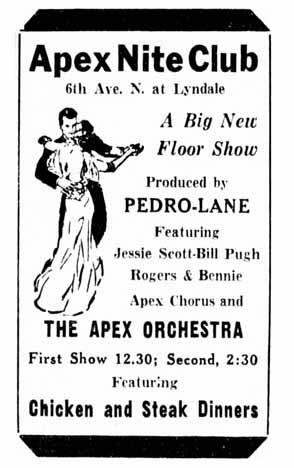
Minneapolis Star, January 19, 1934
As a result of the raid, all licenses were revoked on January 23, 1934. It re-opened a month later under new management. The ad below says the manager is Joe Levy.
In February 1934 we have a Matinee Dance at the Apex featuring Robert Freeman and Willie Davenport and their Brownskin Follies.
On March 17, 1934, the Apex presented “Flashes of 1934,” produced by Pedro Lane. The floor show includes:
- Rogers & Benny
- Georgie Boy
- Bobbie Davis
- Jessie Scott
- The Apex Orchestra
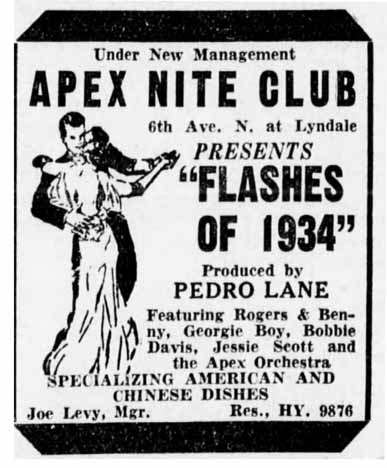
Minneapolis Star, March 17, 1934
In April 1934 we have Frank Hines and His Rhythm Venders, featuring Kelly Stone’s and Eddie Estes’ Brownskin Follies with Dorothy and Gwendolyn.
On December 9, 1934, entertainment is provided by Rook Ganz and his Radio Broadcasting Cotton Club Orchestra. There were two Cotton Clubs – the notorious North Side Cotton Club where a policeman was murdered in 1928, and the roadhouse in St. Louis Park that continues today as Bunny’s. This one is the St. Louis Park Cotton Club.
On December 16, 1934, the Balloon Club presented Rook Ganz and his WTCN Radio Broadcasting Cotton Club Orchestra at a Cut Rate Matinee dance (admission 35 cents).
The next interesting one is on Christmas Eve 1934, with Rook Ganz and Scottie Williams and His Black Cats. Also Mae Nolan, Burlesque Star Will Give Her Late Snake Hips Dance.
The Christmas Afternoon dance featured the very popular Eli Rice and his Dixie Cotton Pickers Orchestra. They took a 90 minute break and played for the Grand Christmas Ball for 1934.
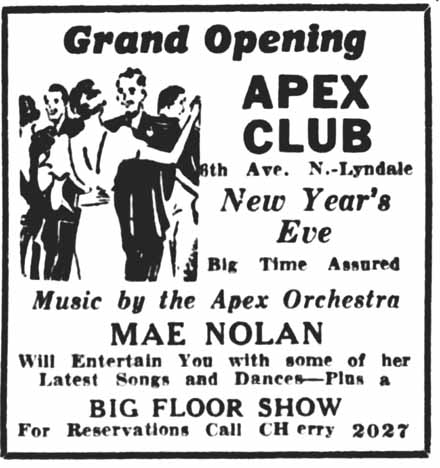
Minneapolis Star, December 29, 1934
1934
HALFWAY CLUB, 635 Sixth Ave. No. SECOND FLOOR
The Halfway Club was on the second floor of the Kistler Building, where the Clef Club musicians might go if the third floor closed down at 4 am.
1935
Every Sunday afternoon beginning on January 13, 1935, Eli Rice provided music for a matinee dance.
Except that on February 17, 1935, the matinee dance presented Robert Freeman and Willie Davenport and their Brownskin Follies from the South Side Auditorium, with the Sizzling Star Ethel Cross. All for 35 cents! The presence of Ethel Cross may have meant that the South Side Auditorium was no longer available for dances.
This fabulous show was repeated the next two Sundays with music by Mack Swain and his Orchestra.
Mack Swain and his 14 piece band was back on Sunday night, March 10, 1935 for a Big Breakfast Ball that started at midnight and ended at 6 am the next day!
Mack was back on March 17 for a big Sunday night dance featuring Robert Freeman and Willie Davenport’s Brownskin Follies, with “Skippy.” I don’t know either.
The next Sunday was March 24, 1935, and the Brownskin Follies and Skippy were back, but Mack Swain was replaced by Eli Rice and his New Band.
Easter 1935 came and with it came a Ball with the Sunny Rice Band and two floor shows. Dancing went on until 3 am. Then on April 23, Rook Ganz took up the baton with His Cotton Club Orchestra for a Big Breakfast Ball that started at midnight. This one was sponsored by the Key Club.
OH YES! BIG SUNDAY NIGHT DANCE, April 28, 1935, featuring Frank Hines and His Rhythm Venders. The two floor shows featured Kelly Stone and Eddie Estes’s Brownskin Follies with Dorothy and Gwendolyn.
I’ll get to the bottom of the P & S Chicken Shack, but not today.
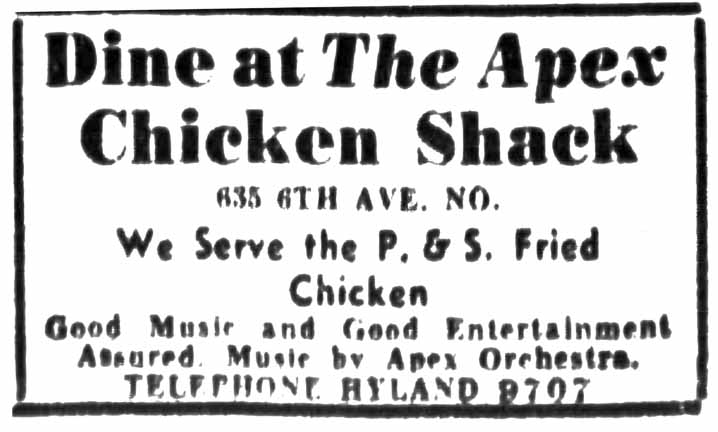
Minneapolis Tribune, May 18, 1935
Rook Ganz and the Apex Orchestra battled it out during a Breakfast Dance that went from June 17 to June 18, 1935.
June 8, 1935 brought Popo Warfield and his Brownskin Steppers for a Big Matinee Dance, accompanied by Johnny Wheeler and His 6-Piece Orchestra. Johnny Wheeler’s combo would entertain every Sunday night starting on June 23, 1935.
In the spring of 1935, Apex Hall owners Ben Wilson and Eugene Moore were convicted and sentenced in district court for operating a house of ill fame. Despite his Mayoral title, Wilson was sentenced to 90 days in the Workhouse. (Minneapolis Star, October 15, 1936)
Rook Ganz and his radio broadcasting Cotton Club Orchestra held forth at a Fourth of July Breakfast Dance that started on July 3, 1935, and ended on July 4. The Apex Orchestra was also on the bandstand.
“After the Aragon,” attend the Breakfast Ball featuring Rook Ganz, beginning at 1:30 am and ending the next morning. When do people sleep?
On August 15, 1935, there was a Battle of Music and Breakfast Ball that started at Midnight. It was a benefit for Citizens Community Union Picket Lines, and featured four bands:
- Rook Ganz and His Cotton Club Band
- Scottie Williams and His Black Cat Orchestra
- C. Sharp and His Seven Flats
- Apex Night Club Band
“Help Us Help Our People”
In August 1935, a small fire on the second floor was reported in the building. Several fires had been reported there in the last few months.
On August 19, 1935, Grant Moore and His Orchestra provided the music for a Breakfast Ball. “Come out and hear a real band,” read the ad.
The Well Known Wee Willie and His Apex Band provided the music for a matinee dance on Sunday afternoon, September 15, 1935.
After that, on Monday night, September 16, 1935, come back for a Breakfast Dance with Rook Ganz and His Radio Broadcasting Cotton Club Band, starting at midnight and ending at breakfast the next day.
After the Ball at the Aragon, Follow the Crowd to the Big Breakfast Dance, Featuring Rook Ganz. There’s no date on the ad, but it’s from the Minneapolis Spokesman dated October 7, 1935.
The Apex really outdid itself on October 19, 1935. Van Epps & Clifton Phelps produced a spectacular floor show that included:
- Mitzi Coleman in her Rhythm Tap
- The Bowen Sisters doing the Shim Show
- Clifton Phelps – Dancers de luxe
- Hamet Five & Van Epps in Underworld Apache
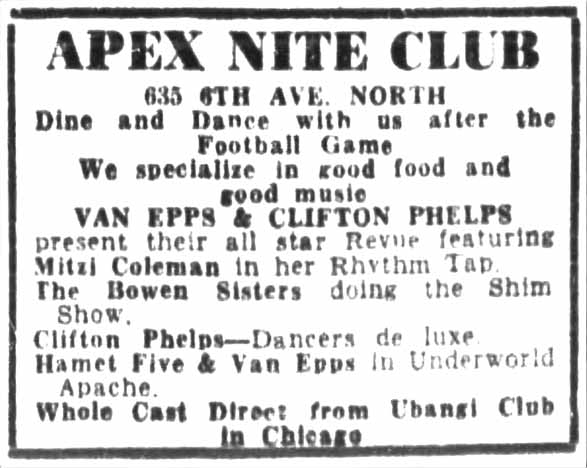
Minneapolis Tribune, October 19, 1935
Halloween 1935 was here and the Apex Hall offered 2 Bands 2: Rook Ganz and His Cotton Club Orchestra, with Bill Pugh, Magic-Voiced Singer, and the Apex Band. The floor show featured Van Epps & Clifton Phillips’ Revue with the Brown Sisters.
November 13, 1935 brought a Cabaret Ball (which was apparently a term of art that I can’t define) featuring Walter Barnes and His Creolians. “Come out and hear this world famous band.”
On November 20, 1935, a dance was given in honor of Noble Sissle and his company. Music was by the Apex Band, and the floor show featured McDonald, Clifton Phelps, Van Epps, and the Apex Chorus. Twin City Musicians and Entertainers will be out in full force to welcome Sissle Company. Sissle was in town for a week to entertain at the Orpheum Theater in tandem with the showing of the Kay Francis movie “I Found Stella Parish.”
Another undated but close-to-Thanksgiving event was a Breakfast Dance with two floor shows featuring Ethel Cross and the Apex Orchestra.
Then beginning on Thanksgiving Eve, November 27, 1935, there was a Cabaret Ball and Battle of Music between two popular nite club bands:
- Clarence Johnson’s Stumble Inn Orchestra
- The Apex Nite Club Band
The First Matinee Dance of the Season was on December 8, 1935, with the Apex Orchestra vs. Clarence Johnson’s Stumble Inn Aces. The Floor Show featured:
- Ethel Cross, the Torch Singing M.C.
- Sonny Nichols, RKO Favorite
- Epps and Phillips, Dancers Excellent
The prizes were a box of cigars for Gentlemen, Combination Cigarette Lighter for Ladies.
December 15, 1935, was a Sunday matinee, where you could dance to the music of Rook Ganz and His Famous Cotton Club Band. See also our new floor show, featuring Ethel Cross, Mistress of Ceremonies.
Christmas 1935 was a test of endurance at the Apex; Christmas night you could hear Ethel Cross, the Torch Singing M.C. and see Pearl Harvey, “Petite Dancer.” Ethel Cross was also the person to call for information. Then the Second Annual Christmas Ball began at 11 pm until 7 am, featuring Rook Ganz’s band, Ethel Cross as M.C., and Pearl Harvey in a Holiday Floor Show. Can one woman a floor show make?
December 31, 1935’s ad said “Now Open.” Ethel Cross and her dancing buddies were featured.
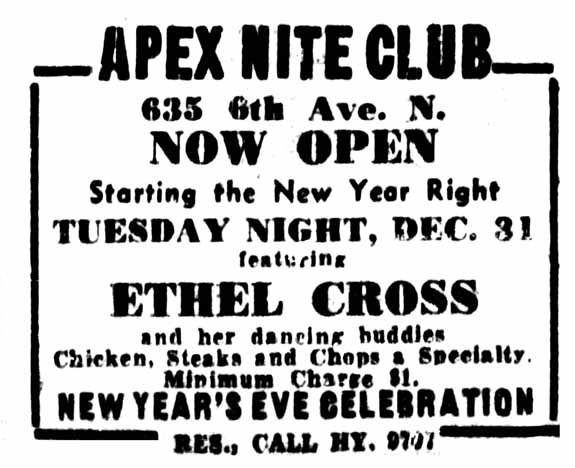
Minneapolis Tribune, December 31, 1935
1936
On February 25, 1936, the Apex Club was raided and Ben Wilson was arrested for keeping the Apex open after hours and serving moonshine whiskey.
Wilson, Eugene Moore, and Esther Kaplan, the owner of the property, were tried and convicted – Moore was convicted for operating a house of ill fame on March 12, 1936. The judge ordered the Apex padlocked on March 10, 1936 for one year.
1937
A fire on October 8, 1937, damaged furnishings in the basement and in the Keystone Bar on the first floor of the building. There was smoke damage to a candy shop and barber shop in the same building, estimated at several thousand dollars. (Minneapolis Tribune, October 9, 1937)
The Apex was back in business on October 10, 1937, with Rook Ganz holding forth at a Sunday Matinee Dance – Cabaret Style. (Given the fire, it’s possible this dance didn’t actually happen since the Spokesman was a weekly and published ads in advance.)
Rook Ganz was replaced by Boyd Atkins, a member of Ganz’s band, at the Cotton Club on April 1, 1936, “and has packed the place to the doors ever since.” Apex dances were being held only on Sundays in 1937. (Minneapolis Spokesman, October 22, 1937)
Boyd Atkins and His Famous Cotton Club Orchestra played at a Sunday Matinee Dance on November 7, 1937. There was also a special floor show.
A few days later the Johnny Backer VFW Post and Auxiliary sponsored an Armistice Celebration and Dance on November 11, 1937, with the Lord Byron Doty Orchestra providing the music.
On November 21, 1937, Apex Hall was the site of the Season’s First Full-Length Cabaret Dance, featuring two Mammoth Floor Shows. Music was provided by the Rook Ganz Orchestra.
An ad in the Spokesman for a Big Thanksgiving Dance on November 25, 1937, just gave the location as Kistler Hall. Music was provided by the Lord Byron Doty Orchestra.
Similarly, on December 31, 1937, the place of the big New Year’s Eve Night Dance, sponsored by the Johnny Baker Post 291 of the American Legion, was just given as Kistler Hall. “Make Whoopee,” read the ad. Unfortunately, on January 7, 1938, the Spokesman reported that “Vandals Attempt to Halt Legion New Year Dance.” When Legion members went to the hall to prepare for the dance, they found every light bulb smashed and the entire lighting system wrecked. The electric power box had been pulled from the wall.
With the old army spirit the post members got together and with the assistance of the Minneapolis Electric Company’s trouble shooter and others, the hall was almost ready at 10 pm when the first New Year’s celebrator reached the hall.
1938
COTTON CLUB CAFE, 635 Sixth Ave. No. THIRD FLOOR
The Cotton Club Cafe opened on May 14, 1938 on the third floor of the Kistler Building, but probably not for long. The ad below promises that there would be entertainment nightly, but focused more on the food, with chicken and steak dinners, sandwiches, and the best barbecue in the Twin Cities. And it was open day and night! It probably had no beer or liquor license, and no matter how good your food is…
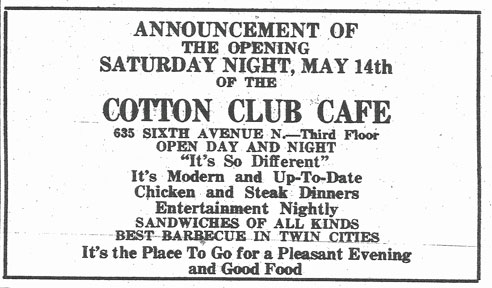
Minneapolis Spokesman
There was just one more ad that I found in the Spokesman, for a Fourth of July (1938) Breakfast Dance and Amateur Dance at the “New Cotton Club,” featuring “Doc” Pettiford and his Swing Band with Floor Show. Dancing and entertainment from 1 am until dawn. Dance given by the Twin City Progressive Club. Not sure if this is the same thing, but the location is given as Sixth and Lyndale.
CLEF CLUB: 1939 – 1943 THIRD FLOOR
The Clef Club was the successor to Apex Hall, and was mentioned in the Spokesman in August 1939 as newly redecorated. Boyd Atkins and his orchestra played a “Jim Jam Jive Session” on Sunday, August 27, 1939.
In November 1939 the Clef Club presented “That Sensational, Petite, Dynamic Artist Dorothy Adams, Direct from Grand Terrace, Chicago, plus Pal Tillman and His Harlem Syncopators.
On October 26, 1940, the club was again described as newly decorated and reopened with a “big imported floor show.” “The Clef Club will be the night club in the Twin Cities catering to Negro patronage,” reported the Spokesman. Manager Scottie Williams promised a show with “a snappy group of entertainers” including:
- Carroll Lee, female impersonator
- Alma Smith, torch singer
- Chase and Ray, the “Brown Dots,” dancers par excellence
- A chorus of “Four Lovelies,” in a show produced by Jackie Hudson
- Music by Walter Lear and His Six-Piece Orchestra
Professional musicians who were in town would come to the Clef Club after their last set and jam all night; the list includes Art Tatum, Benny Goodman, Gene Krupa, Tommy and Jimmy Dorsey, Woody Herman, Fats Waller, Artie Shaw, Charlie Barnett, Erskine Hawkins, Jack Teagarden, Cab Calloway, and Earl Hines, according to Ira Pettiford. Leigh Kamman said that bassist Oscar Pettiford “had his humble beginnings at the Clef Club.” As did his brother, Ira, on the trumpet.
The sessions got to be so popular that matinees were organized in the afternoons, after which the band would go out to the Cotton Club on Excelsior Blvd. in St. Louis Park and play until 1 am. Harold “Popeye” Booker was the pianist at the Cotton Club. Then they would go back to the the Clef Club and really start jiving, said Pettiford.
In December 1940, the floor show featured:
- Jessie Scott (doing the “La Congo”)
- Skip, Hop and Jump: Three Dancing Demons
- Music by Walter Lear and His Gents of Rhythm
The owners were listed as Sylvester Oliver, Ben Wilson, and Scottie Williams.
In January 1941, Earline Williams was the headliner. She was described as a recording singing star, direct from long engagement with Harlan Leonard’s Kansas City Orchestra.
Oh dear. The Clef Club, now “The Home of Happy Feet” presented a gala affair on December 21, 1941, featuring “Snake Hips” and His Rhythm Girls, Peggy O’Neal from Chicago, and Little Bobby Green. Music by Steep Pittman and His Musical Gents. Snake Hips and the gang were also on hand at the Clef Club for a Breakfast Ball on Christmas Eve Night and a dance on Christmas night.
THE GREAT CLEF CLUB RAID
On January 15, 1942, the Clef Club was raided “accidentally” and 89 people were arrested for being found in a disorderly house at 3 am. Police hadn’t intended to raid the place, but they were on their way to another hot spot when they saw 40 or 50 cars outside the Kistler Building and went to investigate. An undercover man went in to “get a buy” of illegal whiskey, and then it was all over. Patrons tried to escape, but the fire escape and the front door were covered. Rumors of 25 people jumping through windows and escaping were unlikely, since it was a 40 ft. drop.
It took two paddy wagons four trips each to get all 89 people to jail. 25 women were fined $10 each. Four couldn’t pay and were sent to the Workhouse for ten days. Horace George Davis, cafe owner, pleaded guilty to maintaining a disorderly house at the Clef Club, and was sentenced to 90 days in the Workhouse. Ben Wilson was fined $25. The other 62 male defendants were fined $10 each. Many of the men said they were musicians playing in theaters downtown or at an uptown night club.
If that weren’t enough, the Minneapolis Star Journal decided to publish the names, addresses, occupations, ages, and races of everyone who was arrested. And a picture of four of the men behind bars. And two more of the women. On the front page. It was a cruel world in 1942.
A Breakfast Dance at the Clef Club on May 29, 1942, featured Mose Strange and His Hot Band.
The Clef Club hosted a Thanksgiving Ball featuring Jimmy Baker’s Orchestra.
The December 25, 1943, Christmas Cabaret Dance at the Clef Club had music by Jimmy Baker’s Band. The large ad for this dance was published in the Spokesman on December 24, 1943.
It was the Clef Club again for a Cabaret Dances on New Year’s Eve, with entertainment and floor show music by Jimmy Baker’s Band. The Breakfast Balls, featuring Walter Lear and His Boogie Woogie Band, started at 10 pm and lasted all night.
Note that there was an organization called the Clef Club in the early 1920s that organized dances, usually held at the South Side Auditorium. Not sure whether there is any relationship.
1946
On October 24, 1946, yet another fire swept through the building, now in use by the York Rite Masonic Lodge. The third floor ballroom was no longer in use, but as a Lodge ritual room. 12 people had been living in the second floor apartments. The building was still owned by Ben Kaplan.
KEYSTONE BAR
644 Sixth Ave. No.
By all accounts, the Keystone bar was inaugurated in 1935 at 644 Sixth Ave. No., which was in a large 2-story building on the NE corner of the same intersection as the Kistler Building.
Its first proprietor was Lawrence Leonard, although it had mob ties six ways to Sunday. On May 22, 1935, it advertised its “Swanky New” Cocktail Room (for Ladies and Gentlemen) (No stags admitted to Cocktail Room) held its Grand Opening. The Cocktail Room was under the Direction of Mr. Duffy Ampey, and the Cafe was under the management of James Wicks. (Minneapolis Spokesman, May 1935)
By June 1935, the Cocktail Room had been renamed the Mystic Cavern. The only Mystic Cavern anyone remembers, however, was in St. Paul.
In November and December 1935, one could be entertained with piano music by Ed Pursell in the main bar, or the Silver-Voiced Baritone Jack Meridith in the Mystic Cavern.
Herman Brown must have been the proprietor in 1937, as he was given 30 days in workhouse on a liquor charge that September.
In 1938, plans were made to remove 644 Sixth Ave. No. for the widening of Sixth Ave. No., and the owner of the building was awarded $22,225. (Minneapolis Star, July 19, 1938) 644 Sixth Ave. No. was wrecked in March 1939.
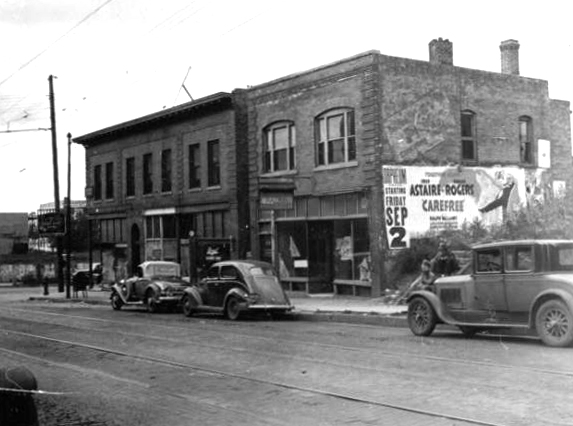
644 Sixth Ave. No., 1938. Photo courtesy Hennepin County Library, via Alan Slacter
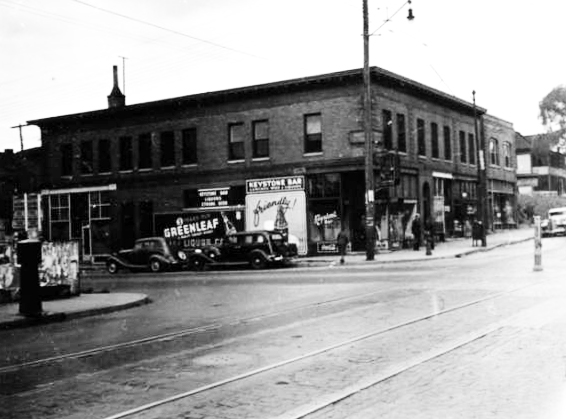
644 Sixth Ave. No., 1938. Photo courtesy Hennepin County Library, via Alan Slacter
THE KEYSTONE AT THE KISTLER FIRST FLOOR
It’s unclear when the Keystone moved to the Kistler, but where it went, trouble followed.
In January 1939, the Crime Sheet says that the Keystone was operated by Joe Miller, and that the player piano was robbed of $25 worth of coins. This happened again in March 1939, if “music machine” is the same as the player piano.
From 1938 to 1956, article after article described shootings, sluggings, robbery, knifings, prostitution, and other quite bad behavior at the Keystone Bar. The proprietors in 1945 were I.
Oleisky and T. Della.
The photos up top and below from February 1957 indicate that the bar was probably there until the bitter end of the Kistler Building.
639 CLUB: 1944 – 1948 FIRST FLOOR
In 1944, this club was one of five that was accused of being an all night club where prostitution, and gambling go on all day and night. This came up in the trial of a case of white slavery. (Minneapolis Star, March 23, 1944) A fire on February 19, 1948, revealed that the 639 Club was on the first floor of the Kistler Building.
EBONY SOCIAL CLUB: 1948 – 1957 THIRD FLOOR
The following comes from an article in the Minneapolis Spokesman dated February 26, 1954:
John W. Ritchie was a World War II veteran who settled in Minneapolis, looking for a business venture. He turned a small shoe shining stand in the Greyhound bus depot into a chain of stands in Minneapolis, Fort Snelling and the Midway, some of which included dry cleaning services.
1948-1949
In 1948 he took over management and ownership of the pool hall in the Kistler Building, and in 1949 he purchased the Kistler building. He remodeled the second floor, converting it into an apartment hotel. On the ground floor he established several businesses including a record shop and a cafe.
1950
Ritchie continued to be the proprietor of the pool room on the first floor. Jerelein May Jones graciously allowed me to post her Facebook comment:
My husband Bart (Hobart) says where the Ebony Club was in the Kistler building, in 1950 it was a pool hall owned and managed by John Richie. Bart says, as a youth of 16, he worked there as a rack boy. When pool players game was over and they called out “rack house,” Bart would rack up the balls for whatever game they were playing (9 ball, 8 ball, rotation,or straight). He would sometimes get tips from winning players who gambled on their game. Bart’s dad, Spence Jones, shot pool there for many years and had a reputation for his skill with a pool cue. The owner, John Richie , was also a skilled pool player and sometimes he and Bart’s dad would “get it on” in a game of 9 ball or straight pool, with spectators standing around watching. Also, in the rear of the pool hall, were card tables, where the gamblers played cards. Tonk and Blackjack were popular, among other card games.
1952
1952 he spent $3,000 to reinforce the floor and roof framing of the assembly hall and the balcony and extend the balcony. In 1954 he remodeled the third floor into a dance hall. Eventually named Ebony Social Clubf, it is described in the Minneapolis Spokesman on February 26, 1954 as a
spacious dance hall with hard wood flooring, supported by two under-floors insulated with sound proofing material. It was equipped to seat over 200 people around the dance floor in seats of the latest vinyal (sic) plastic upholstering material, for easy, comfortable seating.
On one side of the room is a lounge with tables and chairs capable of seating a hundred people. The mezzanine above the lounge enables spectators to view the entire dance floor and the curved bandstand in the northwest corner of the building. A service bar for serving refreshments is equipped for both the Mezzanine and main floor. The hall will be available for parties, lodge meetings and other community meetings.
1954
In July 1954 Ebony Social Club was announced as a new dance hall, “delightfully cooled by nature,” which probably meant there was no air conditioning.
In August 1954 it is revealed that it is the home of George Watson Post 522 and showcased Oscar Frazier and his Combo Fridays through Sundays.
On August 23, 1954, police conducted a raid on the hall, calling them the clubrooms of the George Watson Post 522 and charged Ritchie with operating a public dance without a license. Ritchie was commander of the Post. The club was selling tickets from a ground level booth, making it a public dance. 150 people were in the place when the police arrived, and two bars were in operation. Two bartenders were also arrested. 25 whisky bottles were found and many dancers brought their own bottles. (Minneapolis Tribune, August 23, 1954)
Ebony Social Club held its Grand Opening Dance on December 30, 1954, with music by Eddie Boyd and His Orchestra (Ellis Productions). The next night, Prince Rogers and His House Rockers were the musical attraction.
1955
Lewis Buggs and His Combo, featuring Prince Rogers at the piano for your dancing pleasure, appeared at the Ebony Social Club on January 7-9, 1955.
Tiny Bradshaw and His Orchestra appeared at the Ebony Social Club on January 28, 1955.
An ad in the Spokesman dated August 26, 1955, for the Ebony Social Club says “Plan to Attend our Long Awaited Re-Opening.” Perhaps that escapade with the illegal dance in 1954 got the place shut down for a while.
The Weekend of August 26 – 18, 1955 featured music by Oscar Frazier and His Combo.
By October 1955 it is billed as the “Midwest’s Most Fabulous Spot.”
In December 1955 it is “The Twin Cities Most Beautiful Ballroom.”
James Moody and His Orchestra appeared at the Ebony Social Club on December 30, 1955.
1956
In January 1956, Ritchie was convicted of allowing “spiking” of drinks at the dance hall and given a 60-day suspended jail term.
Danny Overbea and His Orchestra appeared at the Ebony Social Club on January 20, 1956.
Sonny “Long Gone” Thompson and his Orchestra appeared at the Ebony Social Club on February 16, 1956.
As a result of his conviction, in February 1956, the City’s license committee voted to revoke Ritchie’s licenses for both the pool hall and the dance hall. Other people applied for the licenses, but were turned down as they were seen as “fronts” for Ritchie.
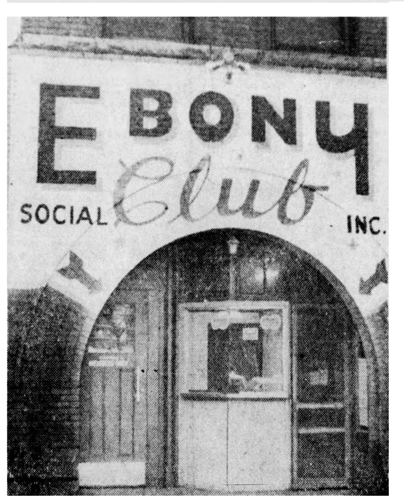
Door to the Ebony Social Club. Minneapolis Star, December 14, 1956
On December 28, 1956, Ritchie’s last hope of operating the Ebony Social Club were gone when the City Council denied his application to renew his cigarette, food, and dance hall licenses. The reason given was his personal police record, although he had no felonies. Ritchie took it to court.
The matter turned out to be academic when the building was purchased and demolished for redevelopment.
1957
END OF THE KISTLER
The Kistler Building purchased by the Housing and Redevelopment Authority on August 16,1957, for $62,000. The building was on 12,500 sq. ft. of land. The demolition permit was issued on October 10, 1957, and the building was demolished as part of the Glenwood Redevelopment Project.
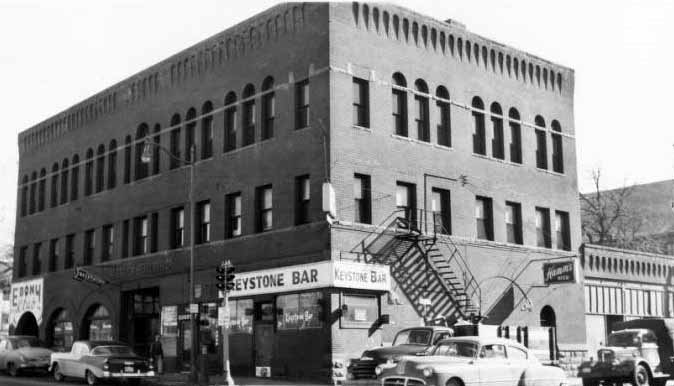
February 26, 1957. Front view from the NW. Photo courtesy City of Minneapolis
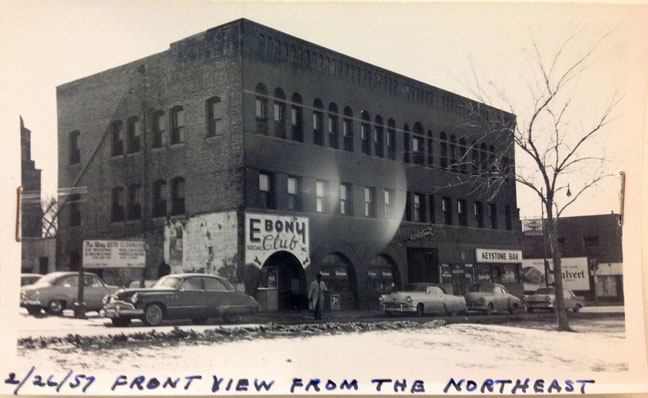
Photo courtesy Kirstin Delegard of the Historyapolis Project
Save
Save
Save
Save
Save
Save
Sixth Ave. No. between Highland and Aldrich: Jazz venue.
The Kiva Coffeehouse was located at 1441 N. Cleveland Ave. in St. Paul, across from the University of Minnesota’s St. Paul Campus.
THE KIVA COFFEEHOUSE
It was only mentioned once in the Minneapolis papers, in a Will Jones column in the Minneapolis Tribune (December 23, 1964) noting that blues musician Lazy Bill Lucas was planning to move to the Kiva on January 1, 1965 for a three-weekend stand.
NEW YORK PUBLIC LIBRARY
But Jones continued that by January 1, 1965, the name of the place would have been changed to The New York Public Library.
By 1973 the address was a dry-cleaning shop.
LORI’S COFFEEHOUSE
By 1993, the space was occupied by Lori’s Coffeehouse, but the only mention in the Minneapolis papers was a reading. (Minneapolis Tribune, February 21, 1993) A look online indicates that it is Lori’s still today, but these days it is hard to tell. By the photo below, it is co-located with Mim’s Cafe.
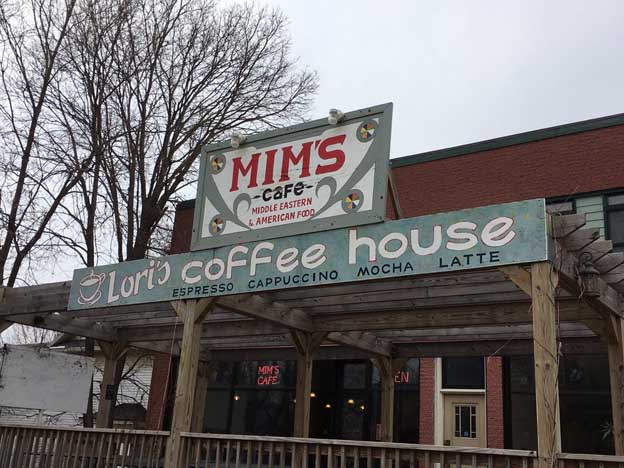
Lori’s Coffee House
The Klondike Bar was located at 326 Cedar Ave. So., on the West Bank, Minneapolis.
Previous to the Klondike it was the Fred Hemmingsen Tavern (1935)
The building burned down on March 25, 1955. The Klondike moved across the street to 329 Cedar Ave., where it was renamed Chuck’s Skol Club.
The building at 326 Cedar was replaced in 1965.
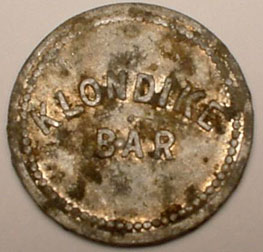
905 – 4th Ave. So. That address is the Gethsemane Church today and may have been St. Thomas Church in the 1930s, as it was the site of the St. Thomas dance and style show.
The Kobbersted dining room and lounge was in the Holiday Inn and Solar Dome at 694 and 100 in Brooklyn Center.
Much of the information below comes from an interview with Phil Eder, who had a hand in all of the businesses below from 1968 to 1987 when the property closed. I thank him for his frank insights on these many ventures!
Koogan’s Leaning Post was located at 5420 Excelsior Blvd., in the Lilac Way Shopping Center, St. Louis Park.
LILAC WAY SHOPPING CENTER
The 30,000 square foot Lilac Way Shopping Center had a prime location at the Northeast corner of Highway 100 and Excelsior Blvd. It was the first in the State, built in 1941. Unlike Miracle Mile, which was built across Excelsior Blvd. ten years later and is often cited as the earliest of its kind, Lilac Way was not so much a strip mall but a series of buildings, and was much smaller that Miracle Mile’s 154,000 square feet. It was also not all built at one time but grew incrementally, and had some standalone buildings.
LAYOUT
The complex was built to go around the corner. In the photo below, the road in the lower left corner is Excelsior Blvd., which was known as Highway 212 at the time. The road at the very top is Highway 100. Parallel to Highway 100 is a service road (now Park Center Blvd.) that was called Wooddale Ave. The large white building facing Wooddale/Highway 100 was called the Lilac Lanes Recreation Building in the initial ad announcing the opening date. The rest of the complex was the Lilac Way Shopping Center. Although many of the stores faced the service road, they all had Excelsior Blvd. addresses. If you follow the long row of stores that face Excelsior Blvd., take the sharp right down the next row of stores (you can see the shadow of the huge Coke billboard on top), the Leaning Post was on the next corner.
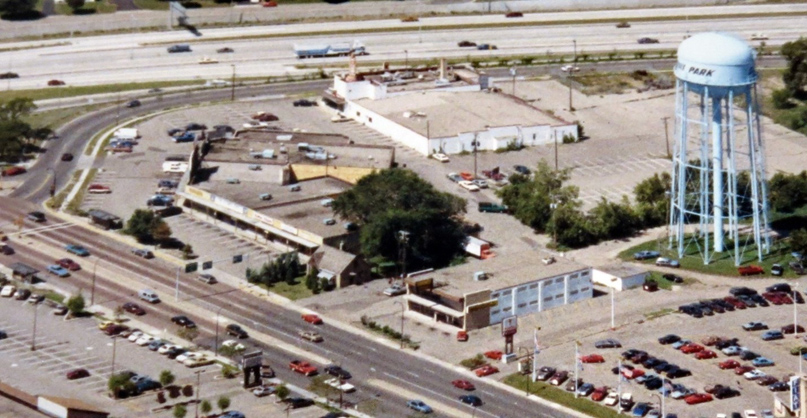
Photo courtesy St. Louis Park Historical Society
FRANK THEROS
The Shopping Center was the brainchild of Frank Theros and Nick Phillips. Theros was born in Olibia, Greece, in 1898, and served in the US Army in France in World War I from 1918 to 1919. According to permit approvals published in the Minneapolis papers, he operated the Ha Ha (as in Minnehaha) Cafe at 2629 East Lake Street in 1927 and 1928, and in 1931 he owned the Stadium Café.
NICK PHILLIPS
Nicholas Basil Filosofopoulos was born in Tripolis, Greece in 1891. It is unclear whether he served in World War I, as his record only shows a “Military Date” of December 21, 1918. On his military registration card in 1918 he wrote that he worked at a restaurant.
In the 1930s he lived at the Curtis Hotel in Downtown Minneapolis and worked at the cigar stand in the lobby there. On his World War II draft registration card he wrote that he worked at both Lilac Lanes Cafe and the Curtis Hotel. In about 1940 he moved to St. Louis Park.
Phillips died in June 1958, and the Lilac Way Shopping Center went to his wife Elly. Phil Eder was under the impression that Nick’s will forbade Elly from selling the property.
The Lilac Lanes Cafe/Kings Inn stayed in the Theros family. Frank’s son George took it over from Frank.
5420 EXCELSIOR BLVD.
The first phase of the Lilac Way Shopping Center that opened was the bowling alley, which opened on December 22, 1941.
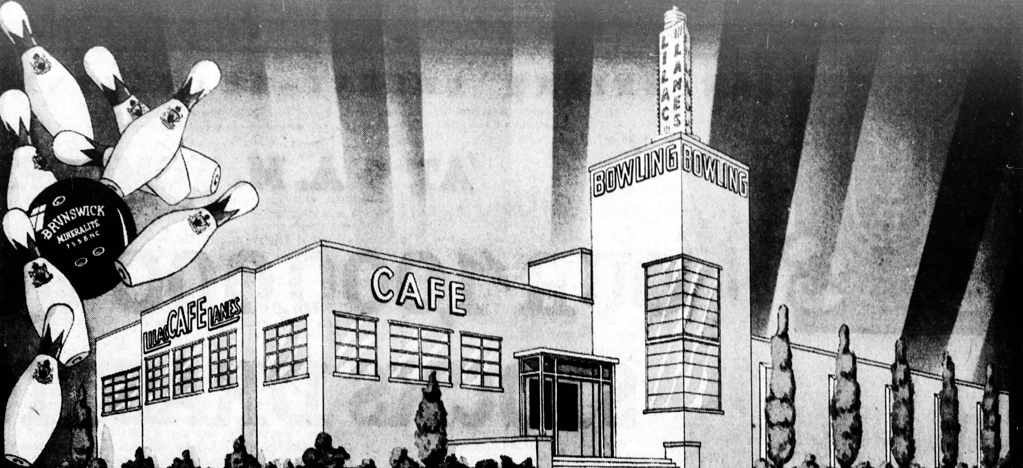
Minneapolis Star Journal, December 25, 1941
On December 27, 1941, the adjoining Lilac Way Cafe, and the first phase of the Shopping Center also opened.

Minneapolis Star Journal, December 25, 1941
The space where the Leaning Post would go is where you see “Belt Line Groceteria” in the drawing above. It was early days and they probably didn’t have the grocery store lined up yet, so that was probably just a placeholder.
The space hosted many businesses over its long life. Here are the ones leading up to the Leaning Post, the last tenant.
NATIONAL FOOD
The first tenant was the National Food store, from 1942 to July 1953. The names National Food and National Tea appeared to be interchangeable.
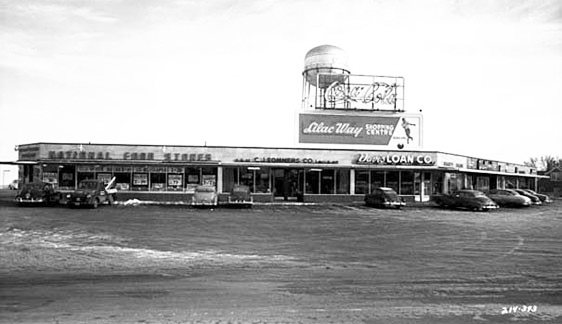
February 1, 1953. Photo courtesy Minnesota Historical Society
LILAC LANES SUPER VALU
On July 9, 1953, the store became a branch of the Hopkins-based SuperValu chain. The roots of this grocery retailer go back to the B.S. Bull, Newell & Harrison Co. Minneapolis wholesale grocery firms. In 1942, the Super Valu name was introduced. Entrepreneurs Winston and Newell formed a voluntary group of stores with an extensive program of services to retailers and stressed nationally advertised brand names. The company’s name was officially changed to Super Valu Stores, Inc.
The store advertised its exclusive “rolling cold” facilities, which meant that meat was refrigerated during all stages of preparation. Other features included air conditioning, magic carpet doors, relaxing music, Witt’s Bakery, Spee-Dee checkout counters, a Kiddie Korral with TV (introduced by Red Owl at Miracle Mile across the street in 1951), and Gold Bond Stamps. The store manager was Ivan Hagen, and Chet Janson was the meat manager. In December 1956, new owner-manager Burton J. “Bud” Amlaw purchased the store from the late Harry Botten.
RUBY’S FINE FOODS
Ruby’s Fine Foods opened in August 1959. It was owned by Morton (“Marty”) Silverman. The article in the Minneapolis Star revealed that the store had 6,000 square feet. Silverman’s family had been in the grocery business for three generations, and his father, Reuben R. Silverman, owned a store on Hennepin Ave. (October 13, 1959)
Ruby’s ran “Lost Our Lease” ads in the St. Louis Park Dispatch in April 1963, and ads to rent the space appeared in the Minneapolis papers in September 1964 to January 1965.
DANTE’S
1965. No idea what this was or where it came from.
BONANZA STEAK HOUSE
1966 to mid- 1968. One of a few around the Twin Cities
BONANZA SIRLOIN PIT
In about September 1968, the Bonanza Steak Houses just changed their names to Bonanza Sirloin Pit – the ads were just the same. It may have gone out of business when its application for a liquor license was denied in July 1969.
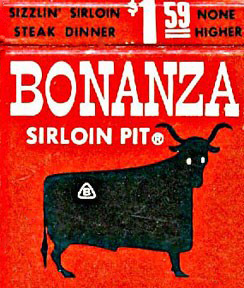
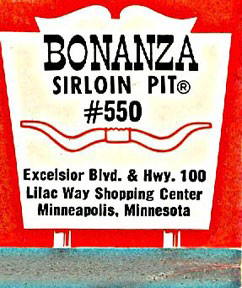
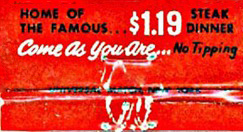
BURGUNDY BULL
The formation of Burgundy Bull Inc. was announced on December 2, 1968 in the Star. Its purpose was to franchise fast food places specializing in burgundy-marinated beef sandwiches. Incorporators were Tom Hastings, N. David Morton, John Noble Jr., and Paul La Victoire.
In the belief that single-food places are becoming obsolete, the units [franchises] also will serve Old English style fish and chips (french fries) and southern fried chicken. They also will have a gourmet carry-out counter.
Phillip L. Eder owned the franchise at Lilac Way. He explained in an interview that their chicken was marinated in dry vermouth, beef in burgundy wine, and ham in tawny port. Perhaps this was to get around the lack of a liquor license? No ads were found in the Minneapolis papers – only quotes on the stock market pages. On May 11, 1970, the Star reported that the company had filed for Chapter 11 bankruptcy.
HICKORY CORRAL
Hickory Corral was also a franchise owned by Phil Eder. Eder got out from under it because the owner was pilfering money. It also did not have a liquor license. Hickory Corral was selling off its chairs, etc. in January 1970
HICKORY WHEEL BBQ
The Hickory Wheel evolved from the Hickory Corral, again owned by Phil Eder and other investors. His investors were against having liquor, so Phil bought them out and applied for a liquor license, which he got. Evidence of the Wheel in the papers is seen from April 1 to June 17, 1971.
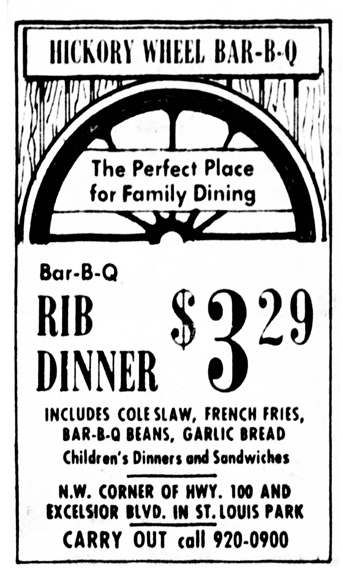
Minneapolis Star, April 1, 1971
(KOOGAN’S) LEANING POST
(Koogan’s) Leaning Post was another enterprise of Phil Eder, Northern Franchises. “Koogan” was Don Koogan, who was married to Bev Aretz, one of the owners. (The Aretz family owned Bunny’s.) He had been a manager and partner at Bunny’s, and moved over to the Leaning Post.
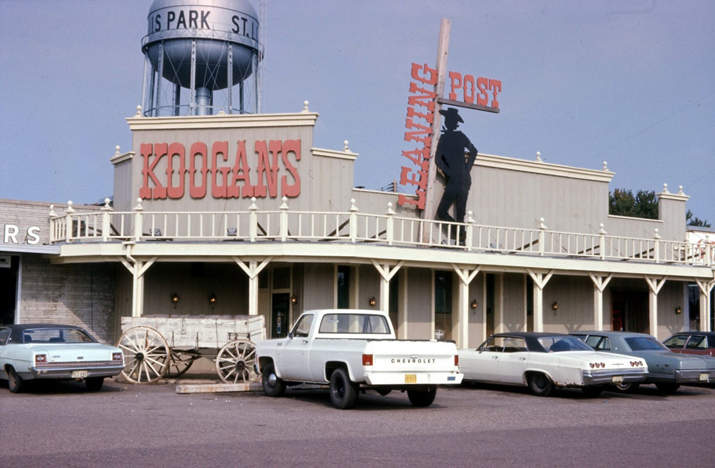
Koogan’s Leaning Post opened in February 1972, well placed for the mass of new drinkers when 18-year-olds were allowed into the bars on June 1, 1973. Phil had the impression that the St. Louis Park City Council was becoming “anti-bar” at the time, however, and was not proud of the Excelsior Blvd. strip that had developed.
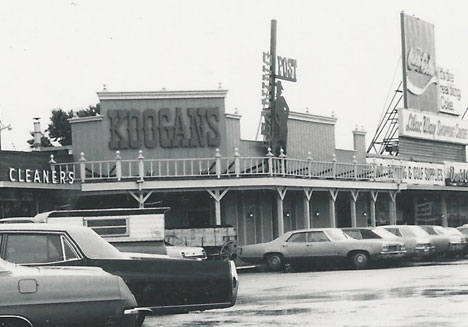
September 1972
The club featured a 22 ft. oval bar. In October 1972 the kitchen was opened.
In 1974 or ’75 Phil bought out Koogan, and took the name “Koogan’s” name off the sign.
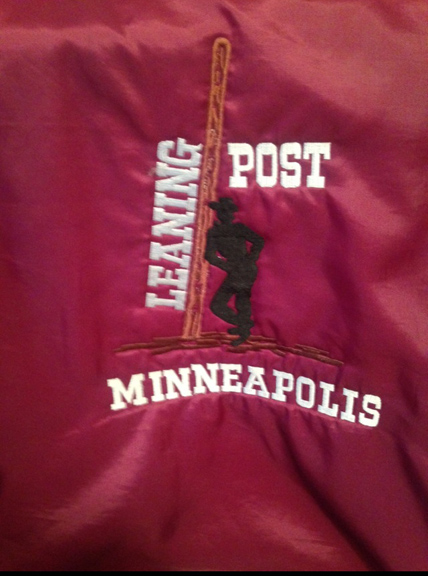
Richard Brown’s cool jacket from “The Post.” Was he staff or on a team?
MUSIC AT THE LEANING POST
In an interview, Eder said that there was live music seven days a week, with the XL-5 as the house band for about five years. On Sundays they would have something “easier,” like the Frank Wagamon Quartet. Other frequent bands were Gangbusters and Headliners.
There are many fond memories of this place, which was sometimes viewed as a “meet/meat market.”
Alex Wilson was a memorable bartender.
Eder said that the place was busy, with as many as 6,000 customers coming through per week. The place got so popular that he expanded by taking over the neighboring barber shop and dry cleaner to use as offices and a coat room.
There were some problems, which was natural when you mixed alcohol with teenagers. On Fridays he would have six security people on hand to extinguish the fights. But he told his staff to be nice to the drunks, since they pay your wages! In the early-to-mid ’80s the papers were liberally sprinkled with reports of thefts and drug busts at the club.
LAST CALL
In the mid 1970s there was increasing talk about designating an Excelsior Blvd. redevelopment district, which threatened the continuing existence of Lilac Way. In August 1976, for the first time there was organized a Lilac Way Merchants’ Association, headed up by Leaning Post owner Phil Eder and relative newcomer Norm Kirchner of the Lilac Way Shoe Store. The Association spent $1,000 of its own money to extend the old west motif of the Leaning Post throughout the complex. (The King’s Inn did not participate.) Efforts to remove the huge Coca-Cola sign from the roof were stymied by the amount of money that Coke was paying Mrs. Phillips, who owned the property.
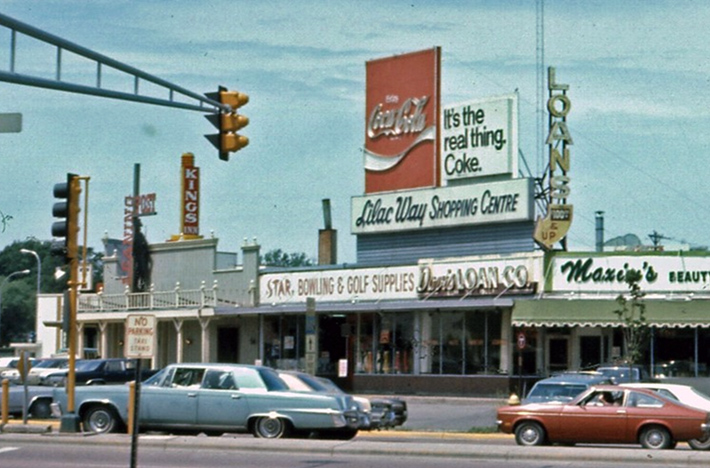
Photo courtesy St. Louis Park Historical Society
Despite these efforts, the old shopping center was ripe for redevelopment. Construction of the 36th St. overpass wreaked havoc on traffic in the area, and the businesses never recovered.
Eder signed a Redevelopment Contract in 1984, but vowed to stay in business as long as possible. Eventually he took over the barber shop and dry cleaner next door for use as offices and a coat room.
The last day for the Leaning Post was November 17, 1987. On the last three days that the bar was open, drinks were back to 1972 pricing.
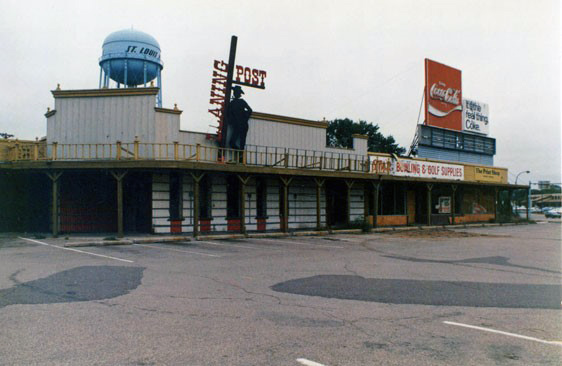
The complex was demolished in September 1988. (Demolition was delayed in the fall of 1987 when soil borings revealed high levels of trichloroethylene.)
The site sat vacant for many years as plans for its redevelopment came and went. The replacement buildings were not erected until 1992 – 1994.
Eder tried to find another location within St. Louis Park, even trying to buy Bunny’s, but with no luck. He ended up buying the:
- Iron Horse in Crystal in July 1977
- Stonewings in Bloomington in 1982
- Stonewings on the Lake (became Maynard’s) in 1985
- Bullrushes in Burnsville in 1985
F.J. Kopesky’s Barn was the site of many community dances in 1928. It was described as on County Farm Road, 3 miles south of Hopkins. County Farm Road is now Highway 169, and the location is in Eden Prairie. Based on info from some Facebook folks, we set out looking for it, and found a barn at Shady Oak Road and Flying Cloud Drive. Fortunately, the man who owned that property was there. He was a Dvorak, a neighbor to the Kopeskys, who lived just north of him and had a truck farm there. Many “Bohemians” farmed in this area, as can be clearly seen in the Census. The spot is now the Flying Cloud Business Center, and the general area is the home of Starkey Labs.
Frank Joseph Kopesky was born on July 27, 1900, to parents from Bohemia. The eldest of seven children, he apparently inherited his parents’ fruit farm. He would have only been in his 20s when he opened his barn to dances – sounds like fun!
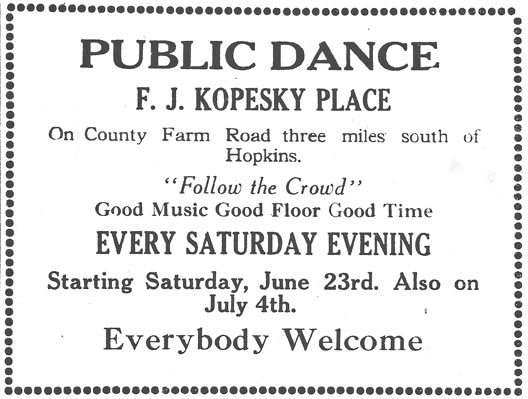
Krueger’s Haymow was described as “a block or so off Highway 100 at South Robert Street, West St. Paul.” Clues to this location are:
- It was described as “past the Corral Drive In.” The present address of the site of the old Corral Drive-In is listed as 1300 Mendota Road E, Inver Grove Heights, which in 2022 is a Home Depot.
- Also, in the 1950s, “Highway 100” was a patchwork of existing roads that the Highway Department touted as the Beltline, before 494/694 were built. The present Highway 62 was likely renamed Highway 100 during this period.
Liner notes from a polka album recorded at the Haymow in 1965 say that the “unpretentious if not austere edifice” was converted from a barn into a dancehall by its owner, Carl Krueger in 1934. However, Carl may have been second generation by 1965; in the obituary of Mrs. Louise Krueger in 1957, it was stated that she had been the owner and manager, and that she was survived by two sons, Gust and Carl. (Minneapolis Tribune, March 7, 1957)
The book Joined at the Hip says that this was the site of some rhythm and blues dances in 1952 – 1953, featuring Percy Hughes and His Orchestra. This is bolstered by two ads found in the Minneapolis Spokesman, a weekly newspaper serving the black community. They are a little difficult to read:
The ad below is for a “Cameo Memorial Eve Cabaret Dance,” held by the Cameo Social Club, on May 29, 1953. Music would be provided by Brown Buddy’s Swingsters.

Minneapolis Spokesman, May 29, 1953
In the same issue was an ad for another dance two days later, featuring the popular Oscar Frazier and Combo.

Minneapolis Spokesman, May 29, 1953
The last entry in the Minneapolis papers was on September 11, 1962, in the Tribune.
Thanks to Derik Olson for information on this page!
This restaurant and nightclub was located at 7800 Computer Ave. (behind Howard Johnson’s and the Camelot) in Bloomington. The building was in the northeast corner of Highways 100 and 494 and was built in 1961.
La Cantina was owned by Pat Moore and managed by Ray “Reggie” Colihan. It operated from about July 1972 to February 1976.
Bands included Rise & Shine, Open Road, Free & Easy, and Danny’s Reasons.
In July 1974 the Bloomington City Council refused to renew its liquor license “because Council members felt too large a portion of its total sales was in liquor.” The restaurant sued to regain the license.
Colihan resigned in October 1974.
ICHABOD’S SOUTH
The building was sold to Charles Howard, the owner of Ichabod’s downtown, and Tom McName, owner of the President Cafe. They opened it in July 1977 as Ichabod’s South. It was a disco that drew a young, professional, and mostly single crowd.
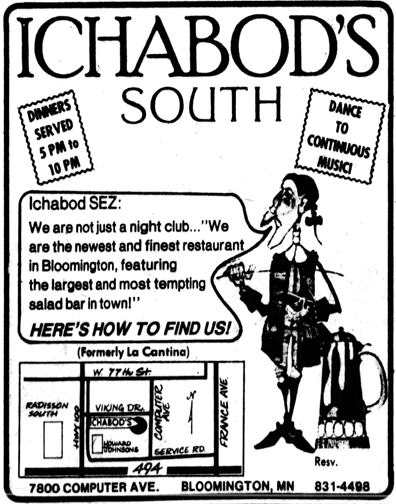
July 14, 1977
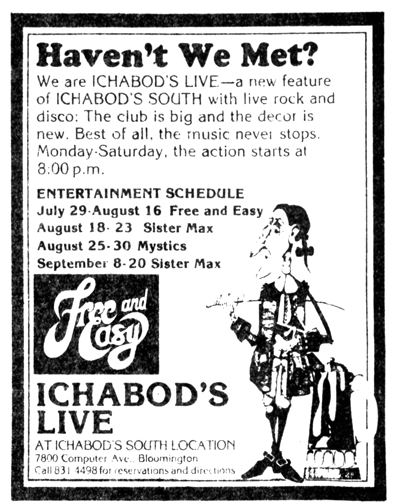
August 3, 1980
7800 Computer Ave. was City Limits from July 1981 to April 1982.

Image from Sweet Potato
La Casa Coronado was possibly the Cities’ first Mexican restaurant, site of many Spanish class field trips. The restaurant was opened by Mrs. Elvira, “Vera” “Mama” Coronado. Vera and her husband Arthur, Sr., emigrated to the U.S. from San Luis Obispo, Mexico, in 1924.
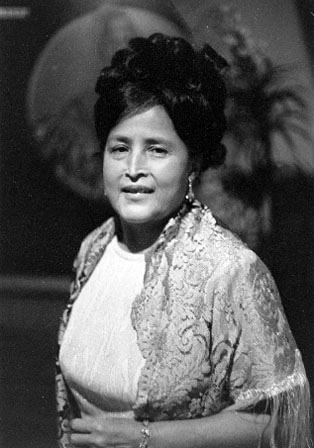
1965 photo of Mama Coronado, Courtesy Minnesota Historical Society
154 E. FAIRFIELD AVE., ST. PAUL
This was the first location of La Casa Coronado. The business was started in 1946 when Mrs. Coronado started cooking tamales and tortillas in “an unimposing frame building” on Fairfield Ave. across from Our Lady of Guadalupe Church.
In a 1951 column, Will Jones described it as “a tiny place with six or seven tables.” Jones said that when she opened it, it was a bustling place, and although it was located in a Mexican neighborhood in St. Paul, about three-quarters of her customers came from Minneapolis.
Mrs. Coronado would visit schools to explain how Mexican food is made and cooked. She learned the business from her father, a restaurateur in Houston. The photo below was part of a four-photo spread in the Minneapolis Star, October 10, 1947, that showed 40 fifth and sixth graders from the Edith Cavell school in Minneapolis making a field trip to the St. Paul restaurant the day before. Mexican food was new to most of them.
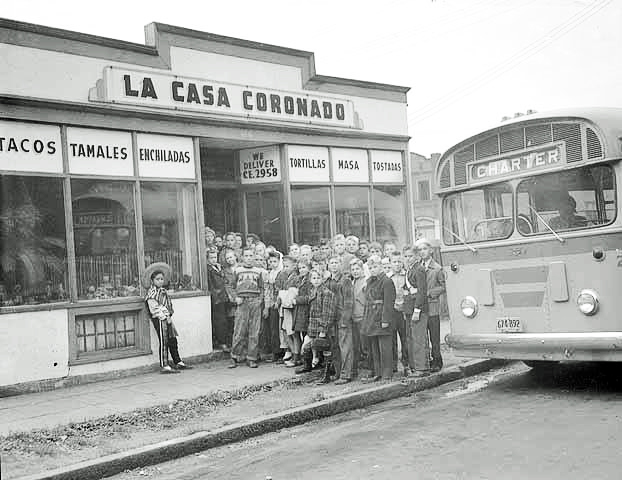
Photo by Russell Bull, courtesy Minnesota Historical Society
But Mama was doing too much, and suffered from a bad heart, Jones said, so the place closed down from 1949 to 1951. Fortunately she found a new partner, Mrs. Seraph Sanchez, and the restaurant opened in early May 1951. (Minneapolis Tribune, May 8, 1951)
The business grew and in 1951, Vera’s husband, Arthur Coronado, Sr. gave up his dry-cleaning shop to support his wife’s business. (Minneapolis Tribune, January 26, 1965).
1113 WASHINGTON AVE. SO.
This brick building had three stories, with stores on the first floor and apartments on the upper two. On November 2, 1958, a fire killed a man and displaced 11 people in SRO apartments. At the time, the first two floors were vacant.
On May 5, 1960, Mrs. Coronado moved her restaurant from St. Paul to this location, with the intention of keeping the St. Paul location open for about six months after the Minneapolis site opened. The Minneapolis restaurant served 250 people in two dining rooms, reported Will Jones on March 23, 1960.
The ad below may be hard to read, but it offers the Latin rhythms of the Larry Vasquez combo featuring Francis Lopez, plus music for dining and dancing in the La Terraza room.
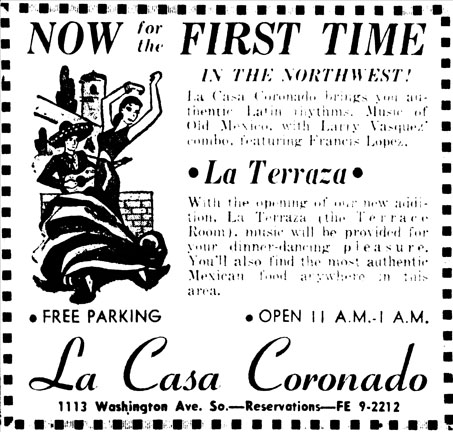
Minneapolis Star, November 3, 1962
In February 1963, La Casa Coronado received the liquor license of the Frolics Bar, which was being displaced by the Gateway urban development project.
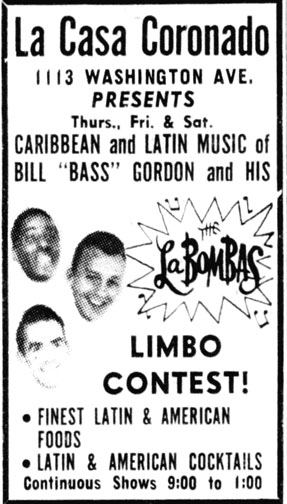
Minneapolis Star, March 20, 1963
In May 1963 there was a new “La Terraza,” the new terrace room, that featured authentic Mexican music, cocktails, and dancing to real Latin American rhythms.
June 1963: “Every Friday and Saturday, authentic Mexican entertainment is provided by the Duo Los Gaonas, and Roberto Del Villor, Mexican recording artist.”
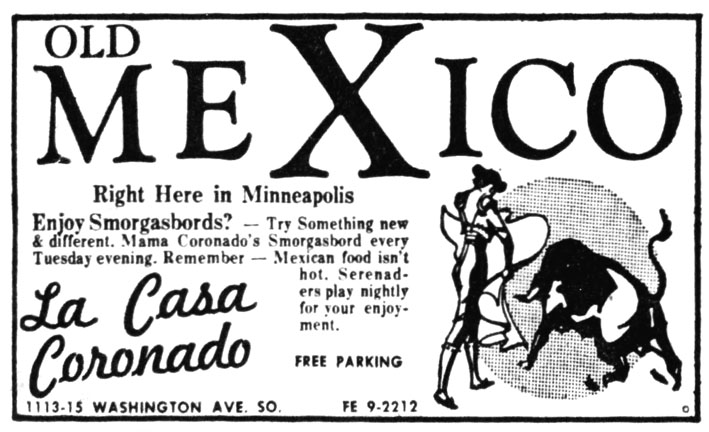
Minneapolis Star, June 19, 1964. Apparently Minnesotans had to be assured that Mexican food was not hot.
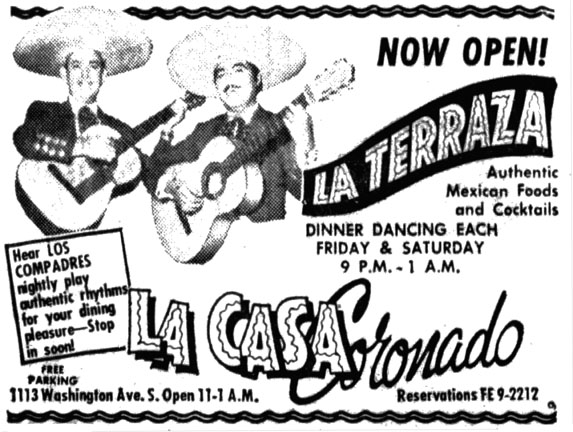
Minneapolis Star, September 22, 1964
On January 25, 1965, fire swept through the building, causing $100,000 in damage to the building. When Mrs. Coronado went to the site and saw her restaurant go up in flames, she collapsed and had to be taken to Divine Redeemer Hospital. The restaurant took up the first two floors of the building. Nine U of M students and a Mexican musician were rooming on the third floor.
At the time of the fire, son Arthur Jr. and four of his six sisters were active in the business. (Minneapolis Tribune, January 26, 1965)
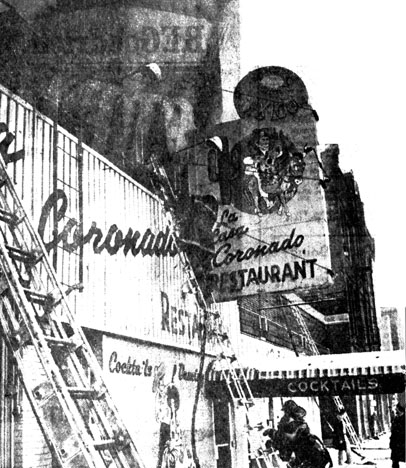
Minneapolis Star, January 25, 1965
The building was demolished in July 1965.
23 N. SIXTH STREET
By April 29, 1965, La Casa Coronado had moved to 23 No. 6th Street. In a familiar pattern, this building had suffered a fire in 1946, when it was a shoe store.
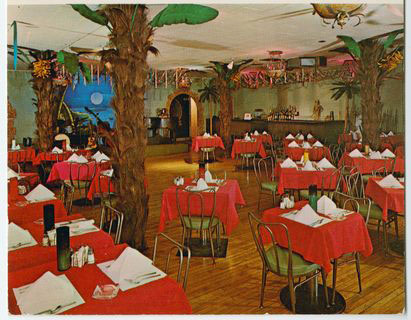
Postcard of dining room, 1965. Minnesota Historical Society
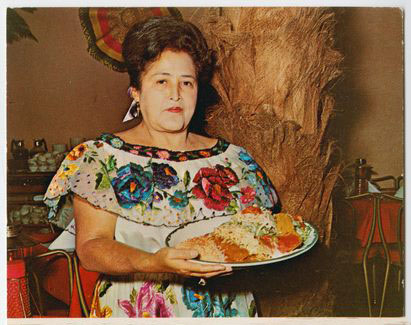
Mama Coronado from 1965 postcard. Courtesy Minnesota Historical Society
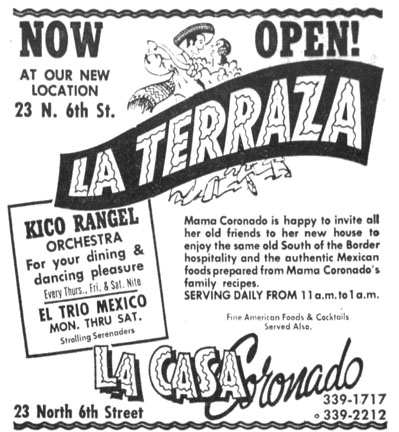
Minneapolis Star, October 21, 1965
In March 1969 it featured the intimate Pancho Villa Cantina and Flamenco guitarists Luella and Ernesto.
The last ad was found in September 1979.
Its assets were sold by the IRS for back taxes in December 1979.
The site has gone through other iterations since then.
Contrary to urban myth and confusion, the Labor Temple is NOT the current Aveda Institute. The Labor Temple was next to that corner building, at 117 Fourth Street SE, Minneapolis, now the Aveda parking lot.
THE AVEDA BUILDING
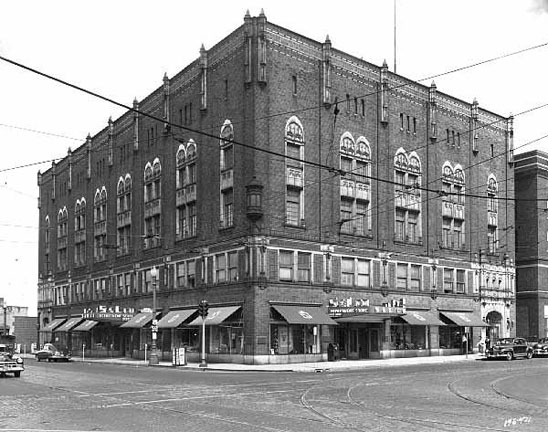
The photo above is the Cataract Masonic Temple on the corner of Central and 4th St. SE, 1950. This is the building that became what we now know as the Aveda Building, and still stands. In this picture, you can just see the edge of the Labor Temple next to it, on the right.
We actually got a tour of this building by an Aveda employee, who was convinced it was the former Labor Temple. Not only that, he said that Janis Joplin and Jimi Hendrix had played there, two acts that had never even played at the REAL Labor Temple! Urban Legends are hard to kill!
THE LABOR TEMPLE
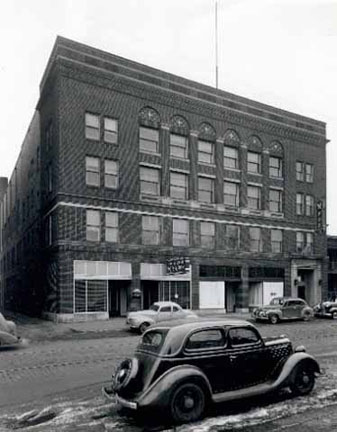
Labor Temple, 1940 – Minnesota Historical Society
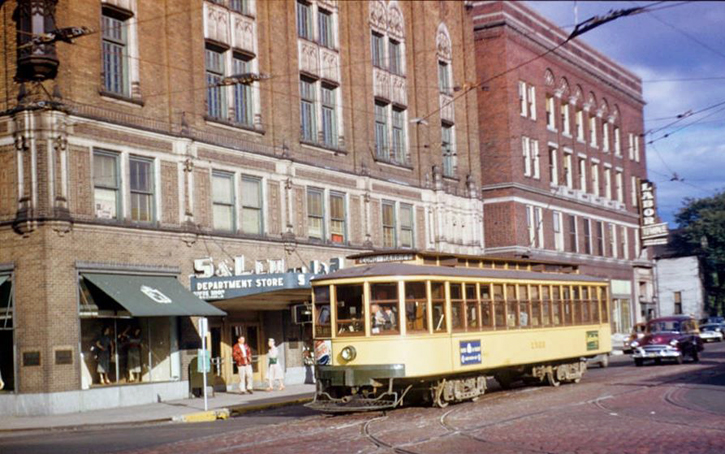
Labor Temple on the Right, 1952. Photo courtesy Minnesota Streetcar Museum, via Alan Freed
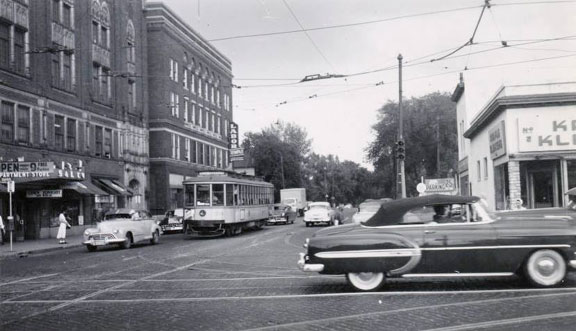
This great photo was taken some time before 1954. Courtesy Minnesota Streetcar Museum
EAGLES HALL
The Eagles Hall was built by the St. Anthony Eagles Aerie No. 1247 , which was different from the Minneapolis Eagles No. 34, which still exists today. At the time they began planning for the new building, the organization was located at 501 E. Hennepin Ave., and already had 2,000 members.
The Hall was built in 1923-1924, at a time when fraternal organizations like the Eagles, Masons, Lions, etc., were growing exponentially. The stated goal of the Eagles was not only to provide help to the needy, but to lobby for an old age pension to be provided by the State of Minnesota, in the amount of $25/month. These were in the days before Social Security.
A sketch of the proposed new Hall appeared in July 1923. Note that the Cataract Masonic Temple does not appear to be to the left, and there is a building flush on the right.
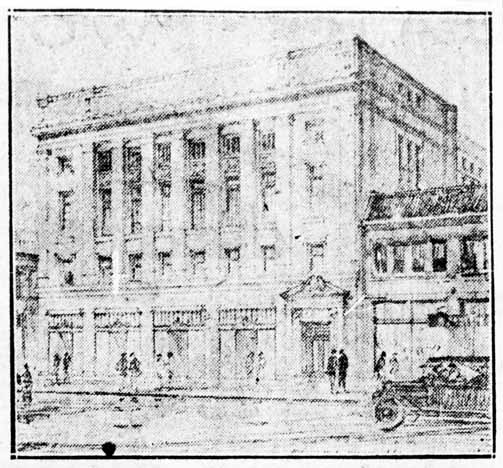
Minneapolis Tribune, July 1, 1923
1923
Original plans, drawn up by Fallows, Huey & MacComber, called for a four-story building:
- The first floor would have four storefronts to be rented out.
- The second floor lodge room would seat 500. The secretary’s office and other rental offices would also be on the second floor.
- The third floor auditorium would occupy a space of 78 ft. by 112 ft., with a large balcony, with a seating capacity of 2,500. A large dining room would also seat 500.
- In an unspecified area (perhaps in the basement) would also be a bowling alley, billiard and pool tables. (Minneapolis Daily Star, January 13, 1923)
On February 11, 1923, 325 new members were initiated into the St. Anthony Aerie. With 2,000 members already on the rolls, their goal was to have 3,000 members by June 1, 1923.
City records show that a building permit for an 88 ft. x 166 ft. foundation and floor slab was issued on June 20, 1923, and a permit for the construction of the lodge building was issued on September 29, 1923. The total cost of construction was expected to cost $150,000, most of which had been raised. The news report on the first permit said that the application specified that the foundation had to be of strength capable of supporting a three-story, concrete, brick and tile club house and is to be completed by the following fall, when erection of the clubhouse proper was expected to begin. (Minneapolis Daily Star, June 21, 1923)
Work had begun by July 1, 1923; R. Billingsby & Co., Minneapolis, were the general contractors. Specifications called for a 4 1/2 story reinforced concrete structure with brick exterior and Bedford stone trim. The cornerstone of the building was laid on December 2, 1923, by Mayor George E. Leach. The dedication address was made by Conrad H. Mann of Kansas City, the past grand worthy president of the order. At the dedication, another 273 members were initiated.
SALAMANDER STARTS FIRE !
Yes, started by a salamander and fed by some hay, a fire broke out at about 8 am on December 18, 1923, on the unfinished fourth floor of the lodge, causing an estimated $2,000 damage to the woodwork that held the concrete moulds in place and to some scaffolding. H.P. Stone, who lived directly across Fourth Street from the building, said that the heat from the fire was enough “to take the chill from the plate glass in the front door of his house.” (Minneapolis Daily Star, December 18, 1923)
1924
The building was apparently in use in 1924, as there were boxing matches advertised in October, featuring 30 amateurs. Boxing would be a popular activity in the building, in addition to dances.
The official dedication of the new hall was somehow delayed until December 15, 1924, and the cost was reported to be $300,000 – $100,000 over budget. 2,000 people attended the dedication ceremony, again attended by Mayor Leach; it appears that in addition to the Old Age Pension, the Eagles were also advocating for a child labor amendment to the U.S. Constitution. Musical numbers were presented at the ceremony.
1925
DANCE HALLS AND MORALITY
The next order of business was to apply to the City Council for a dance hall license. This led to a two-hour session of some delightfully fiery rhetoric on the part of some of the Aldermen – or, as the Daily Star described it, “a red hot two hours’ scrap.” The problem was that the hall was considered too close to the U of M and would draw students and harm their morals. Mr. Hawley declared that, “with the possible exception of the divorce evil, the public dance hall is the worst menace confronting the American nation.” It leads to “promiscuousness, [and is] responsible for so many young people being led astray.”
Mr. Bastie countered that “they provide a source of recreation for the poorer employed girls who have no homes of their own.”
Mr. Gisslen pointed out that it would be “better for the students to dance in Eagles Hall than in some of the downtown halls.”
Mr. Hanscom noted, “The membership of this organization includes many prominent officials and citizens … it is inconceivable that it would permit anything detrimental to it…” Store that away for later.
The upshot is that the Eagles got their dance hall permit, but then the City Attorney opined that they didn’t need one if they conducted the dances themselves for their own members of if they rented the hall to other organizations for their own members. So the Eagles, not wanting to pay for a license every year, gave it back to the City. (Minneapolis Daily Star, February 14 and 25, 1925)
IT’S A RAID!!
On April 16, 1925, Federal Prohibition agents “battered down the doors” to the Eagles’ Hall and found either 1) members quietly playing cards, or 2) up to 200 members buying beer, whiskey, and moonshine as if they were in a pre-Prohibition saloon. Some of those on scene were arrested for creating a nuisance, and seven plead guilty.
None of the trustees were there, but when trustee H.L. Lennon heard rumors that the Feds were looking for him, he went down to see what was what, and what was what was that he was arrested. What was particularly galling was that Mr. Lennon was a State Senator (one of those prominent officials and citizens). Lennon expressed great outrage in a long article in the Minneapolis Daily Star (May 8, 1925).
In November 1925, ten went on trial: eight officers (including the chaplain), and two employees. Testifying against them were three Prohibition agents who had gone “underground” and joined the Eagles so they could find out about the basement bar. (Minneapolis Tribune, November 4, 1925)
Five of the defendants (including the chaplain) were dropped), and after a four-day trial, the president, secretary, an employee, and two trustees (including Senator Lennon) were convicted. The maximum sentence was a year and a day. Lennon served some time but got a Presidential pardon.
LET’S DANCE!
The large hall on the third floor was rented out to groups who held public and private events. The Eagles (and later the owners of the Labor Temple) were remarkably open minded about the kind of music they hosted, which included:
- Old Time (perhaps polka, since it was often presented by Whoopie John)
- Craziness (Thorstein Skarning’s Norke Hillbilly band!)
- Dance Orchestras
- Jazz
- Rhythm & Blues
- Rock ‘n’ Roll
Many of these dances were advertised in the City’s regular daily newspapers (the Minneapolis Tribune/Daily Star/Star), and the Minnesota Daily, put out by students at the University of Minnesota.
But many others were only found in the Minneapolis Spokesman, which was the City’s Black newspaper, founded by Cecil E. Newman in August 1934. Thanks to my friend Ellen Lewis, I found about about this paper and accessed it on microfilm at the Minnesota Historical Society. The amazing shows I found there, especially in the 1950s, made me wonder if the white population of Minneapolis even knew about them. The City was pretty well segregated when it came to entertainment, which is why the black community relied on their own dances in places like the Labor Temple and the South Side Auditorium; with some exceptions, they were not generally welcome in the clubs downtown. There are even stories about celebrities like Nat King Cole being turned away. I have no way of knowing whether these dances were mixed or not. If I had been the right age, I would have wanted to be there!
Please note that dance season usually started in late September/early October. Summers were too hot to hold regular dances, throughout the entire life of the building.
1927
The ad below announced the opening dance of the 1927 season. Wonder what the Kloss Novelty Orchestra sounded like?
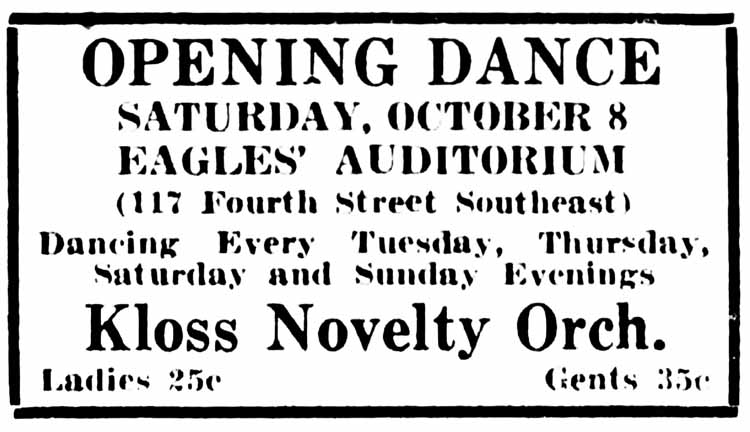
Minneapolis Daily Star, October 6, 1927
The ad below, also from 1927, announces dancing at the New Eagles’ Ballroom every Thursday, Saturday, and Sunday. Music was provided by the popular Eli Rice – his orchestra at this gig was called the 11 Dixie Cotton Pickers.
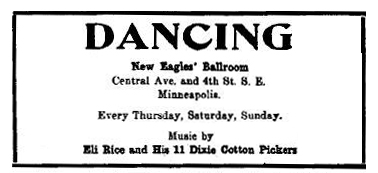
Minnesota Daily, October 1927. Ad courtesy Robb Henry
1930
Permit cards show that in 1930 there was an entry for an undertaker’s business on the ground floor.
In 1930 the Ballroom was apparently still considered new. Eli Rice’s band was very popular around town. These dances were broadcast remotely over WDGY radio.
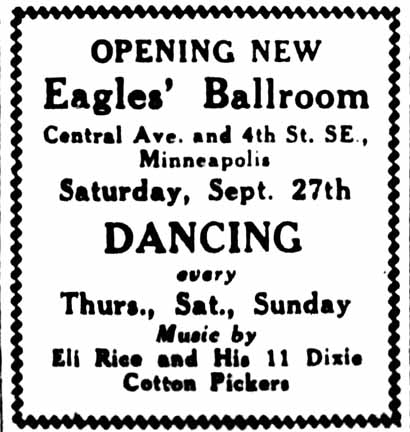
Minneapolis Tribune, September 26, 1930
1931
In April 1931, music for dancing was provided by the Eagles Orchestra, broadcast remotely over WDGY radio.
In 1931 and 1932, the Eagles Ballroom features “Old Time Dances” with the legendary Whoopie John on Fridays, and dances with the music of the popular Cec Hurst Orchestra on Saturdays and Sundays.
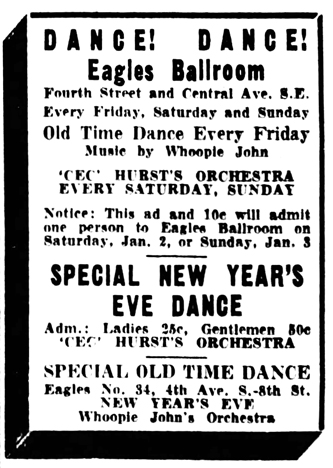
Minneapolis Star, December 30, 1931
1933
Before the National Guard Armory was built in Downtown Minneapolis, there was the Kenwood Armory by the Parade grounds. It was a grand building, but built on an unstable foundation, and in 1933 it was condemned by the City. Before the new Armory could be built, the National Guard needed a place to drill, and one of those places was the Eagles Hall.
Even before the Hall was purchased by the labor unions, it was a popular meeting hall and event center for the various unions in the City. The dance below was under the auspices of the Railroad Trainmen.
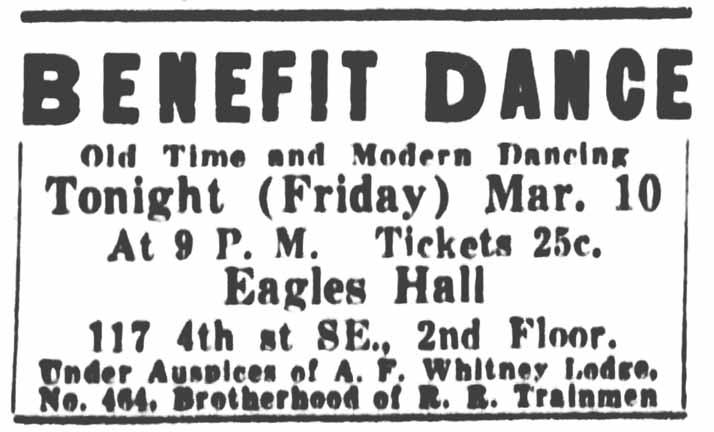
Minneapolis Tribune, March 10, 1933
The Ballroom opened for the 1933-1934 season in October with Old Time dancing with Whoopie John on Fridays and Matt Delong’s Orchestra on Fridays and Saturdays.
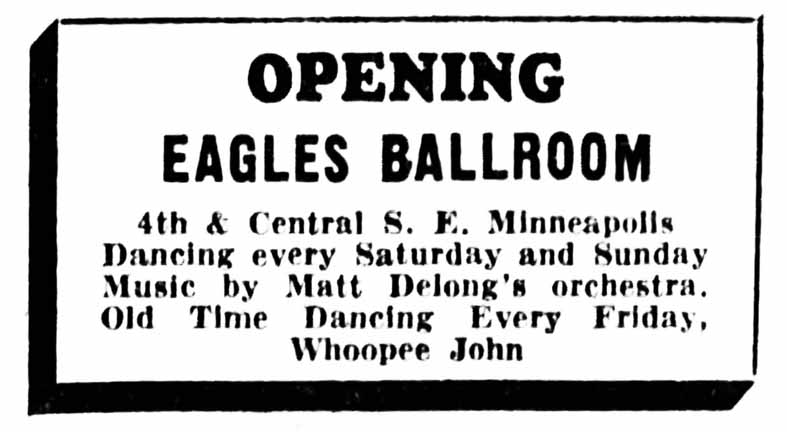
Minneapolis Star, October 28, 1933
1935
On October 31, 1935, Bud Strawn’s Orchestra provided the music for an Old Time Dance, sponsored by the East Side Progressive Club.
1936
The Hall hosted many wrestling matches over the 1936-1937 season.
1937
On January 17, 1937, a 27-year-old young man from St. Paul fell over a third floor banister to his death while exiting a dance.
1938
Waiters’ Union No. 614 sponsored a Cabaret and Breakfast dance on May 21, 1938. Ray Dysart’s orchestra played for the first half of the dance, with Boyd Atkins’ Cotton Club orchestra playing the second half. The Cotton Club band was described in the Spokesman as “one of the top bands in this section of the country,” making its “first appearance at a public dance for several months.”
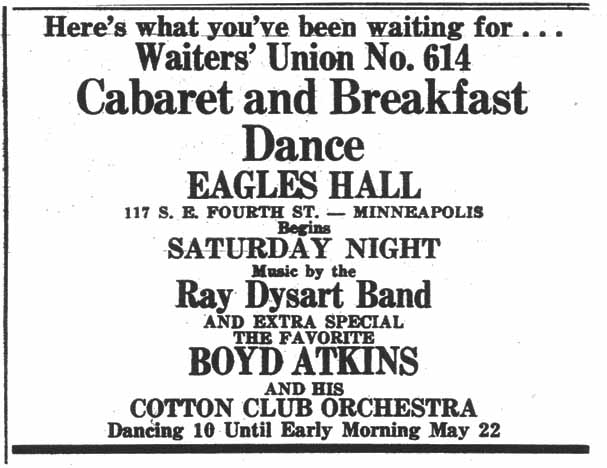
Minneapolis Spokesman, May 1938
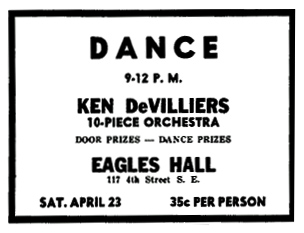
1938 Ad from Minnesota Daily, courtesy Robb Henry
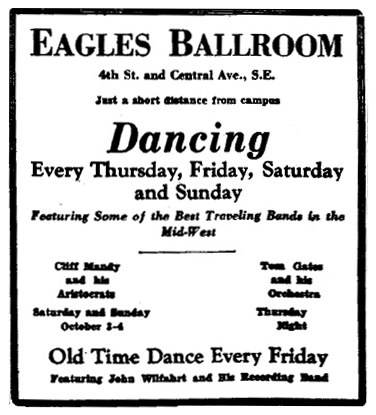
Undated ad from Minnesota Daily courtesy Robb Henry
1939
JITTERBUG JINX
The first annual National Negro Jitterbug Dance Contest was held at the Eagles Ballroom on February 13 and 14, 1939. Lloyd Hunter’s 14-piece band, featuring an all girl floor show, provided the music. “50 Contestants Will Jitter,” with $100 in cash prizes. (Minneapolis Spokesman, January 20, 1939)
However, it turns out that Ray Dysart, who promoted the contest, went back on his word about the $100 prize. Seems that cold weather kept attendance down, and Dysart decided to call off the contest. The rest is a little murky: “He offered $5 to the three finalist couples, he said, and it was accepted. The couples, he said, insisted, however, on going on with the contest.”
Anyway, Mrs. Lucia Bowen went to court, suing Dysart for $55, which was first prize in the contest, on behalf of her son Donald, who won the contest, with his sister Barbara as his partner. The judge took the question under advisement. (Minneapolis Star, March 24, 1939)
Internationally-known dancer Jessie Scott appeared as guest star at a dance at the Eagles Hall on April 9, 1939. She recently returned from a European tour. She last appeared in Minneapolis six years prior “and was the toast of the town.” (Minneapolis Spokesman, April 7, 1939)
Diversity was evident when Thorstein Skarning, Jr., king of the Norwegian Hillbillies, brought his WDGY Barn Dance show to Eagles Hall on Saturday nights in 1939.
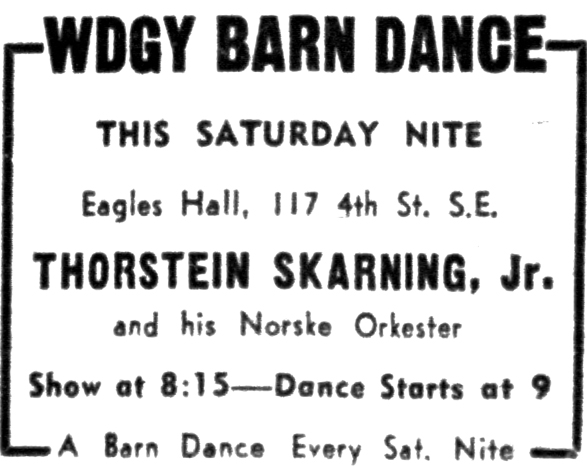
Minneapolis Tribune, October 1939
On November 5, 1939, the Ballroom began hosting Old Time Sunday night dances.
1940
Jimmie Lunceford’s Orchestra came to the Eagles Ballroom on April 23, 1940. Man, does that look like fun!
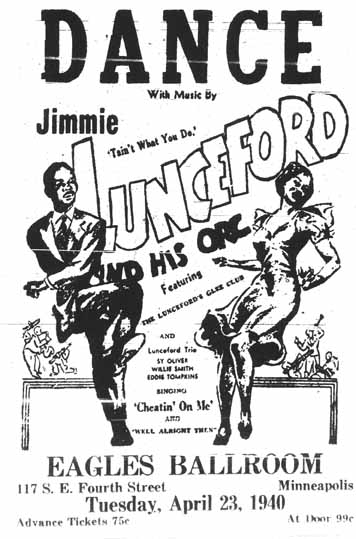
Minneapolis Spokesman
Unfortunately, one of the promoters of the Lunceford show took $500 of the receipts home with him and hid them in a closet. He went out, robbers went in, and the $500 went missing. Police had two suspects. (Minneapolis Spokesman, April 26, 1940)
Thorstein Skarning continued his Saturday night dances in the winter of 1940.
1941
Jimmie Lunceford returned to Eagles Hall on March 20, 1941. A blurb in the Minneapolis Star that day announced:
Jimmie Lunceford, probably one of the best colored orchestra leaders in the business, in town today for his appearance tonight at the Eagles hall, brought with him a curious conviction: Jazz music is becoming tamer. Bill Taylor, local impressario, has rustled a packed ballroom for the Lunceford performance tonight and will have probably 2,000 listeners and dancers.
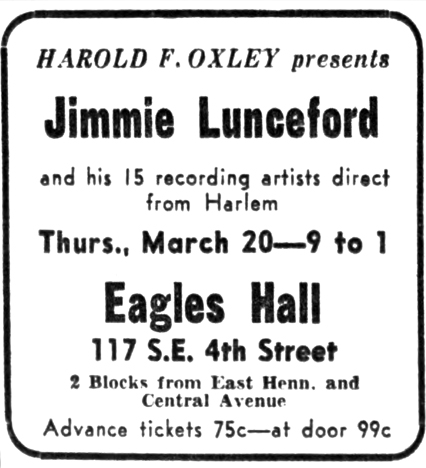
Minneapolis Star
Andy Kirk and His Clouds of Joy was a famous stage and radio band, featuring vocalist June Richmond. The orchestra appeared for an Emancipation Ball at the Eagles Hall on August 4, 1941. (Minneapolis Spokesman, August 1, 1941)
Dr. W.D. Brown was elected Mayor of Bronzeville at the second annual Inaugural Ball, held on Thanksgiving night, November 20, 1941, at the Eagles Hall. Check the link for the fascinating story of the Mayor of Bronzeville!
1942
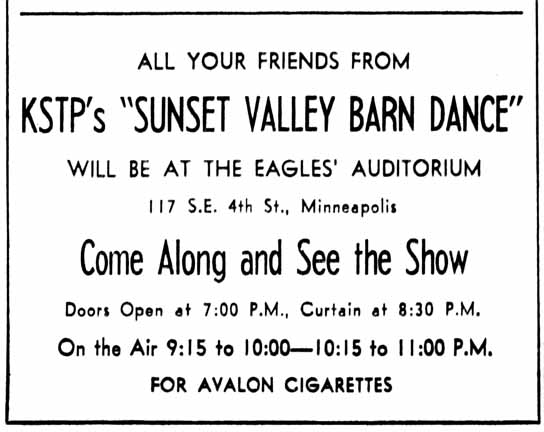
Minneapolis Star, February 14, 1942
The Barn Dance also appeared at the Eagles Auditorium on May 23, 1942, presented by Shell Oil and Avalon Cigarettes.
THE LABOR TEMPLE
On April 8, 1942, the Eagles sold the building to the Labor Temple Association for $65,000. It is unclear just what happened to this Aerie of the Eagles. It appears that it was to replace a building referred to in a dance ad in the Spokesman as the “Labor Hall.” That ad, dated December 22, 1941, gave the address of the Labor Hall as 720 4th Street So., which is a block northwest of the present Vikings’ football stadium.
Remodeling the Eagles building for occupancy by 43 unions was expected to be completed by July 1, 1942. Plans to house the union affiliates of AFL under one roof had started 17 years prior. At one time there was a plan to take over the city’s old East High School building, located at Fourth Ave. So. and Seventh Street, but it had recently fallen through. East High had closed in 1924. (Strib April 19, 1942)
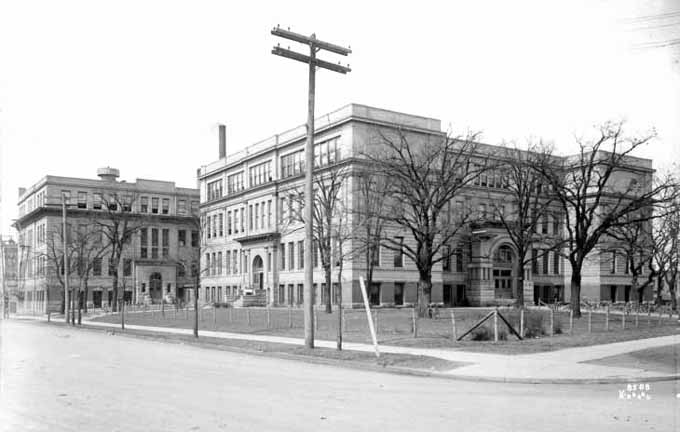
East High School – photo courtesy Hennepin County Library
On June 9, 1942, the deed for the hall was registered in the name of the Minneapolis Labor Temple Association. The building would hold offices for 40 to 50 labor unions and would be remodeled to include 11 meeting halls. The building would be renamed the Olson Memorial Labor Temple in honor of the late Governor Floyd B. Olson. (Minneapolis Star, June 9, 1942)
A 25th Anniversary booklet published in about 1968 revealed that one of the large halls was called Cramer Hall, named after Robley Cramer, “editor of the Minneapolis Labor Review and one of the most militant and fearless labor leaders that the movement ever produced.” The other hall was named after Richard Wiggin, former city attorney of Minneapolis.
In 1942, the new owners continued to rent out the ballroom for concerts and dances.
FLETCHER HENDERSON
Fletcher Henderson and his 14-piece Orchestra came to the Eagles Hall on July 8, 1942. Henderson’s band was “the first ‘name’ band the localites had an opportunity to dance to for several months,” reported the Spokesman.
Fletcher Henderson possesses the ability which few leaders have to inspire their men to their best efforts at all times. With a peculiar rhythmic swing on the piano that is nevere forgotten entirely by anyone who ever dances or listens to it, he can set a ballroom or theatre afire with his interpretation of both popular and old favorites. (Minneapolis Spokesman, July 3, 1942)
Apparently the name of the hall hadn’t changed yet:
A nice gesture of Fletcher Henderson before leaving town to report for a picture at Paramount studios, is to play tonight for a Negro dance at the Eagle’s hall. The town has been talking about Fletcher and his piano playing, his quiet reserved manner. (Minneapolis Star, July 8, 1942)
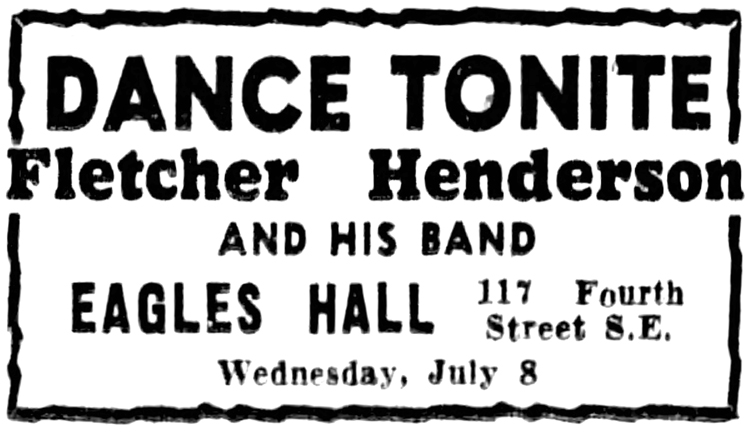
Minneapolis Star, July 8, 1942
1943
Duke Ellington was scheduled to make an appearance at the Labor Temple on Friday, September 18, 1953. The Tribune reported:
Duke Ellington, in the minds of a lot of jazz aficionados the top guy of them all, comes to Minneapolis Friday for an 8:30 concert in Minneapolis Labor Temple, a presentation of D. P. Black, who plans two other fall concerts . . . Ellington for a couple of decades has been in a class by himself as leader, composer, and arranger. His current band includes 15 men and three vocalists, and his program will include such things of his own as “Mood Indigo,” “Liberian Suite,” and “Perfume Suite” . . . He will appear at Sister Kenny Institute Friday afternoon, and will be interviewed by Jack Thayer at 4 pm on WTCN-TV. (Minneapolis Tribune, September 13, 1953)
KSTP BARN DANCE
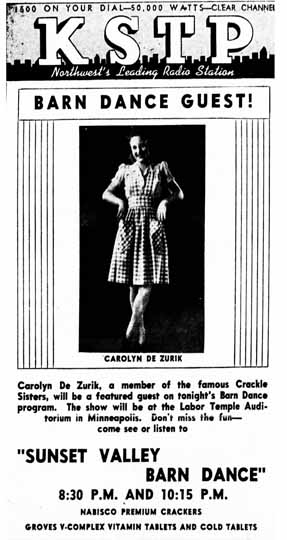
Minneapolis Star, October 16, 1943
1944
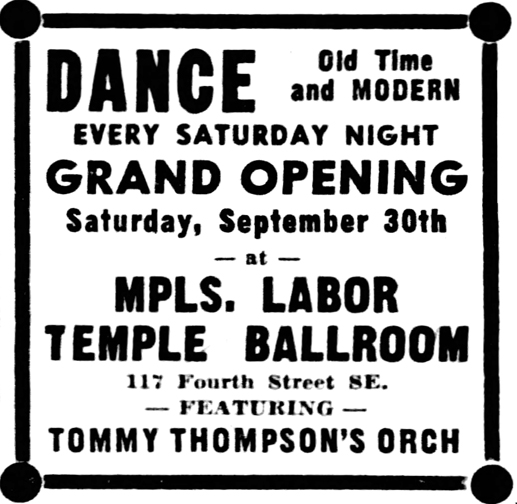
Minneapolis Tribune, September 24, 1944
1946
Ernie Bjorklund’s band was some kind of local/house band that circulated through all the ballrooms in town. An ad shows Ernie playing at the Labor Temple on Saturday nights, the CIO Hall on Sunday nights, and the Marigold Ballroom every Monday and Thursday. Salad days for Ernie’s boys! This scheduled continued to April 1947.
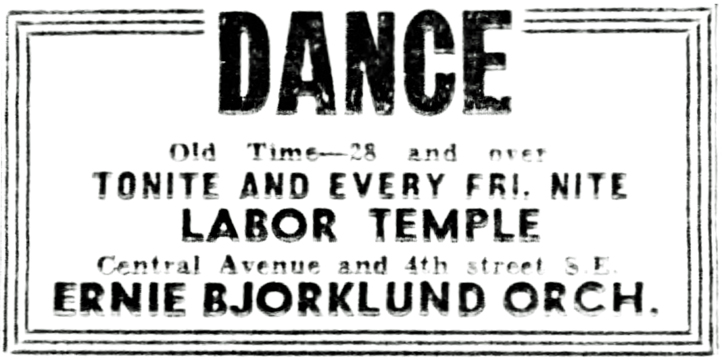
Minneapolis Star, October 11, 1946
1947
The Elks Antler Guard gave a big dance on February 17, 1947, with Joe Broadfoot and His Orchestra providing the music. The venue on the notice in the Minneapolis Spokesman was given as the “Labor Temple, Formerly Eagles Hall.”
April 16, 1947, brought Sy Oliver to the Temple:
Sy Oliver, best known as an arranger for people like the Dorseys, brings his new orchestra to the Labor Temple Wednesday night. With him will be Johnny Moore’s Three Blazers. (Strib April 12, 1947)

Minneapolis Tribune, April 1947
Note that one of the places to buy tickets was the Dreamland Cafe, one of my favorite buildings!
A dance was held on August 31, 1947, with music by Bruce Dybvig and his Orchestra and the Prince Rogers Combo. Dybvig was a white big-band leader; Prince Rogers was the stage name of John L. Nelson, the father of Prince Rogers Nelson. Wikipedia says that Nelson’s career became active in 1948, but this ad shows that it was at least 1947.
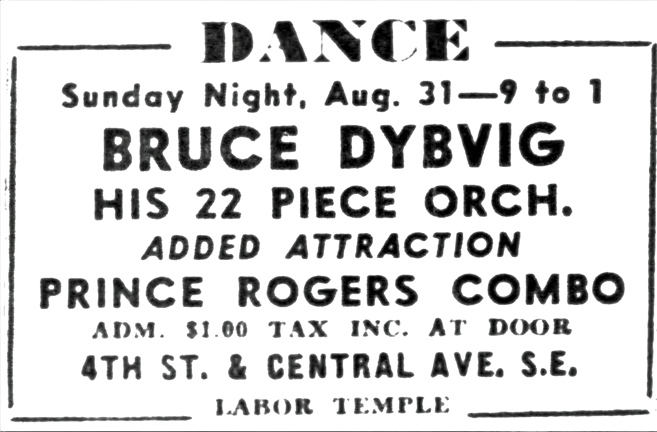
Minneapolis Star, Saturday, August 30, 1947
A dance at the Labor Temple on October 31, 1947, featured Bessie Givens and a 9-piece orchestra.
The Labor Temple was the site of the Elks’ Big Battle of Music on November 24, 1947, with the Percy Hughes Band battling it out with the New Prince Rogers Orchestra.
The Mayor of Bronzeville Fifth Annual Ball was held on November 27, 1947, at the Labor Temple.
1948
Doc Evans was a Dixieland artist, Lonnie Johnson was a “blues shouter,” and Jimmy Yancey was a boogie-woogie, eight-to-the-bar piano player. It was Evans’ first appearance since the “We Call it Jazz” concerts in the Fall of 1947.
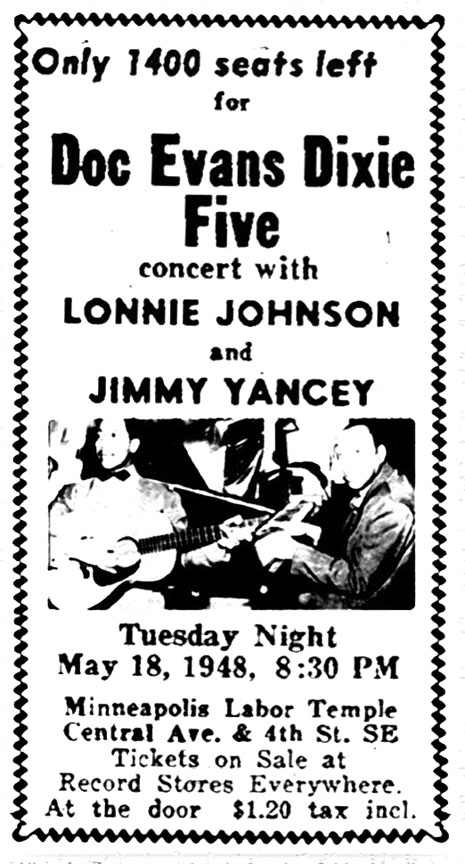
Minnesota Daily, May 1948. Ad courtesy Robb Henry
The Elks held a pre-convention dance at the Labor Temple in May 1948, with music by Arty “Fritz” Watkins and His Northern Lights Orchestra.
Vic Lassine’s Orchestra provided the music for dancing every Friday night in June 1948.
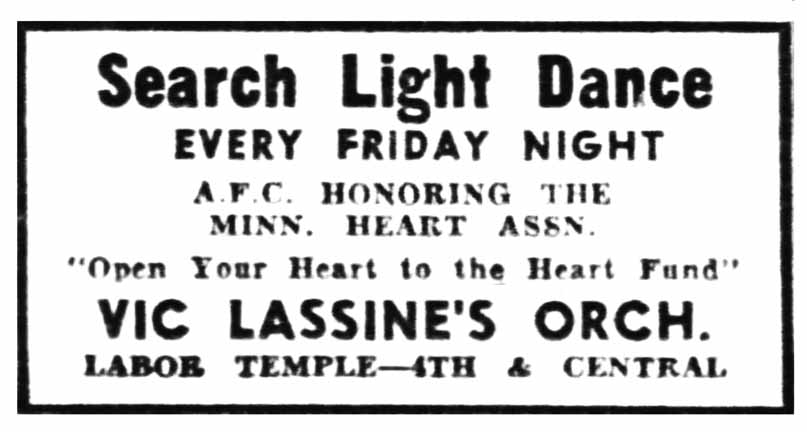
Minneapolis Tribune, June 4, 1948
A Thanksgiving Eve Ball at the Labor Temple on October 24, 1948, featured Lottsa Poppa! (Nat Towles) and his orchestra.
1949
A pre-Fourth of July dance on July 2, 1949, at the Labor Temple featured Nat “Lottsa Poppa” Towles and his new orchestra and entertainers.
Percy Hughes had spent the winter of 1948-49 as the house band at Snyder’s Night Club in downtown Minneapolis and the summer of 1949 at Bar Harbor in northern Minnesota. In September he returned to Minneapolis and played at the Labor Temple, again with singer/wife Judy Perkins.
1950
This ad was in a story about a sudden proliferation of Bingo games in the City.
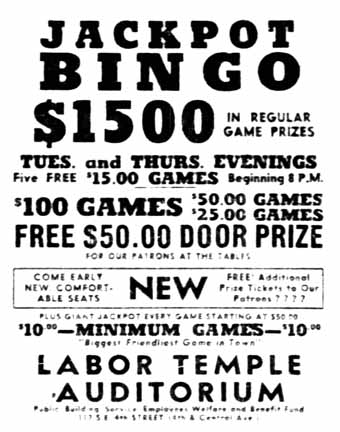
Minneapolis Star, March 13, 1950
The DFL Rally featured entertainment brought in from the clubs on Hennepin Ave. Hmmm…..
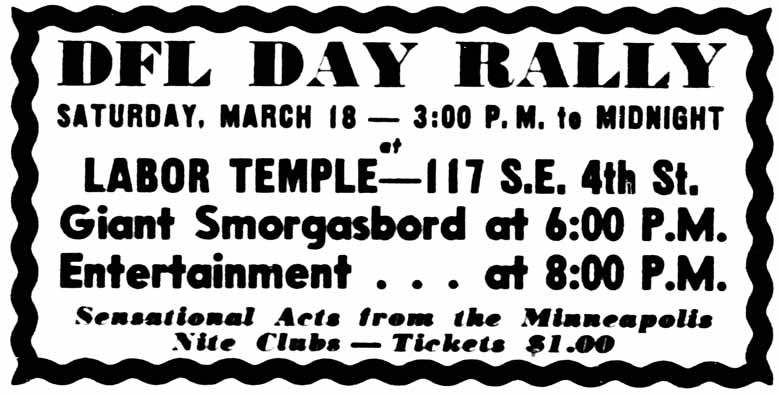
Minneapolis Tribune, March 18, 1950
The Minneapolis Socialite Club sponsored an Easter Sunday Dance at the Labor Temple, featuring the music of Percy Hughes.
A “Pre-Mom Day Dance” at the Labor Temple was sponsored by the Friendly 16 Club on May 14, 1950. Music by Percy Hughes and His Rhythm Boys featuring Dick Mayes.
A June 3, 1950, show featuring Nat “Lottsa Poppa!” Towles Orchestra and Revue with the Edwards Sisters and Tiny Kennedy, King of the Blues Singers, took place at the Labor Temple.
A “Battle of Swing” was swung on September 3, 1950, at the Labor Temple from 3pm to 1am. Percy Hughes and his orchestra battled it out against Bob Bass and his orchestra.
A public jazz concert and dance was held on September 25, 1950, featuring Rook Ganz “and a group of local jazz artists.” Frances Fisher was the vocalist, and Tommy Lewis was m.c.
WEBSTER AND BLACK
From October 1950 to 1956, Rufus Webster and/or D.P. Black brought major national rhythm & blues acts to Minneapolis, almost exclusively to the Labor Temple. Will Jones described Webster as a pianist at Cassius’ Bamboo Room, and that he was going into the promotion of jazz concerts with name artists. Follow the link above to read much more about Rufus Webster. I have not found anything about who D.P. Black was – perhaps Deborah Black?
Shows with an * were promoted by Webster and Black.
A pre-Halloween dance was held on October 30, 1950, at the Labor Temple featuring Dinah Washington (“Queen of the Juke Boxes”) and the Calvin Bose Orchestra. * This was Webster and Black’s first promotion.
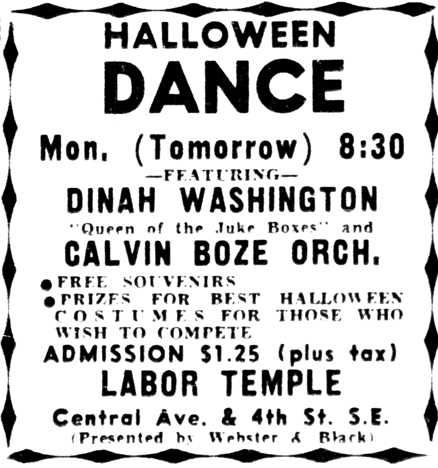
Minneapolis Tribune, October 30, 1950
The Duke and Dutchess Club sponsored a Thanksgiving Matinee Dance at the Labor Temple on November 23, 1950, music by Percy Hughes.
1951
Eddie “Cleanhead” Vinson and His Orchestra, January 1, 1951 *
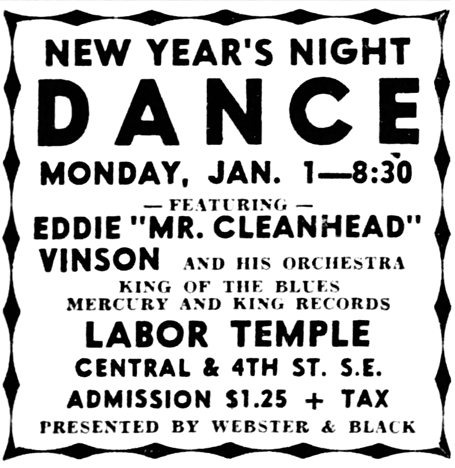
Minneapolis Star, December 1950
Illinois Jacquet and His Orchestra, January 27, 1951 *
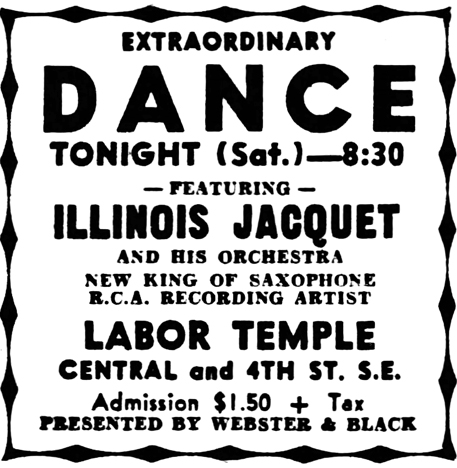
Minneapolis Tribune, January 27, 1951
Sonny “Long Gone” Thompson and His Orchestra, February 24, 1951 *
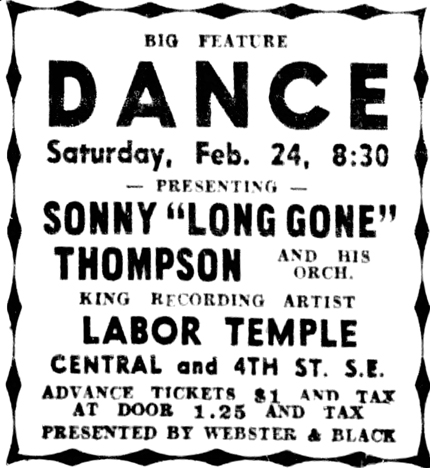
Minneapolis Tribune, February 1951
Lowell Fulson and His Orchestra featuring Ray Charles, March 9, 1951 *
Earl Bostic and His Orchestra featuring Dinah Washington, returning by popular demand, April 9, 1951
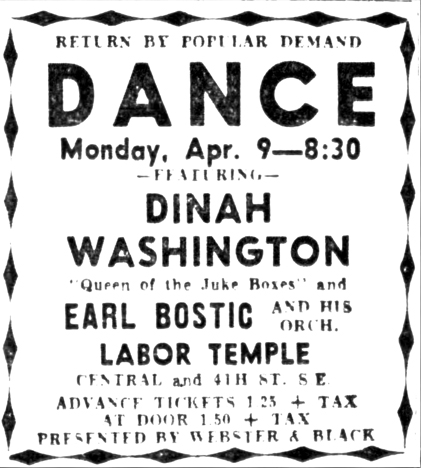
Minneapolis Tribune, April 1951
Cootie Williams and the Ravens, May 29, 1951. “This is Double! The Greatest Attraction of the Year! This is a Sensation and You’ll Enjoy It!!”
BATTLE OF THE BLUES
The “Biggest Battle of the Blues” was staged on July 8, 1951, featuring: *
- Wynonie Harris, “Mr. Blues”
- Annie Laurie, known for her rendition of “Since I Fell for You” and “I’ll Never be Free”
- “Sticks” McGhee – His big hit was “Drinkin’ Wine Spo-Dee-O-Dee.”
- Eddie Durham and His Orchestra
By this time, Harris had recorded:
- “Who Threw the Whisky in the Well”
- “Grandma Plays the Numbers”
- “Good Rockin’ Tonight”
- “I Feel That Old Age Coming On”
Minneapolis Spokesman, July 6, 1951
Roy Milton, “Mr. Blues Himself,” and His Orchestra, with dynamic vocalist Lillie Greenwood and Johnny Rogers, “the wizard of the guitar,” August 11, 1951
Roy Brown and His Mighty, Mighty Men, September 1, 1951 *
Eddie “Cleanhead” Vinson, September 22, 1951 *
Percy Hughes and His Orchestra performed at a special NAACP Membership Dance on September 24, 1951
Ivory Joe Hunter and His Orchestra, October 20, 1951
Tom Archer (Wynonie Harris’s sax man) and George Floyd (vocalist with Fletcher Henderson), November 25, 1951
VANDALS WREAK HAVOK AT MPLS. LABOR TEMPLE
Joe Thomas and His Orchestra, December 31, 1951 *
Despite the presence of three police officers, “hoodlums” tore plumbing and a radiator from the wall in the men’s lavatory while the New Year’s Eve dance was going on. “Police believe the vandalism was premeditated and might be the result of a grudge against promoters Webster and Black who have been bringing dance attractions to the hall for the past year.” A “gang of young toughs” broke a pane of glass in a door to get in without paying admission. (Minneapolis Spokesman, January 4, 1952)
1952
Shows with an * were promoted by Webster and Black.
Duke Ellington, January 23, 1952
Arnett Cobb and His Orchestra, March 14, 1952
On April 15, 1952, Bullmoose Jackson made an appearance at the Labor Temple. *
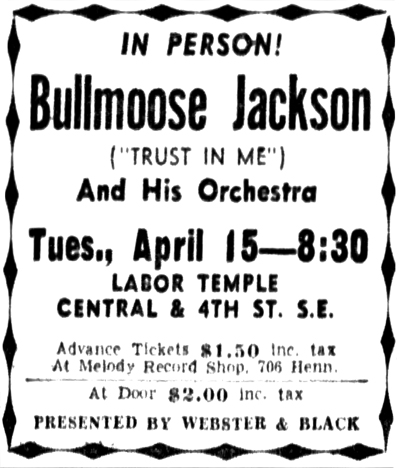
Minneapolis Star, April 1952
Joe Liggins and the Honeydrippers, May 1, 1952
Preston Love and a Mammoth Floor Show with torch singers, dancers, comedians, May 17, 1952 *
Johnny Otis and His Orchestra, Pre-Decoration Day dance, May 29, 1952 * Otis’s vocalist was Little Esther, a/k/a Esther Phillips. Others in the cast were Mel Walker and Willie Mae Walker. “Otis is known as the only white conductor of a Negro orchestra.” (Minneapolis Star, May 27, 1952)
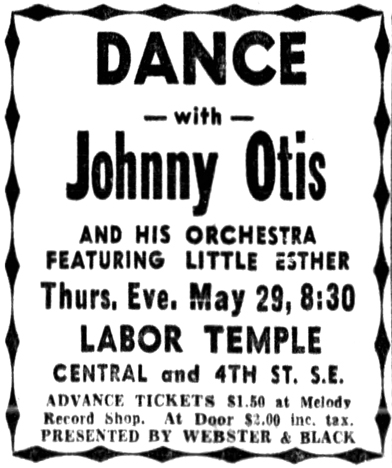
Minneapolis Star, May 1952
Todd Rhodes and His Orchestra, June 14, 1952 *
Roy Milton and His Orchestra, with Lillie Greenwood and Johnny Rogers, July 19, 1952
Gene Ammons and His Orchestra, September 14, 1952 *
Jimmy Witherspoon and His Great Orchestra, October 18, 1952 *
Hal “Cornbread” Singer and His Orchestra, “America’s Most Exciting Saxophone Star,” October 4, 1952
Sonny Thompson and His Orchestra, November 1, 1952
Roy Milton and His Orchestra, November 10, 1952 *
Willis “Gator Tail” Jackson, November 22, 1952. Ellis Attraction. “Gator’s Groove” – whatta tune!
Todd Rhodes and His Orchestra, featuring Little Miss “Sharecropper,” who was pictured but not named, but we know her as LaVern Baker. The show was on November 7, 1952. *
Hal “Cornbread” Singer, December 27, 1952
1953
Shows with a * were promoted by Webster and Black. Those with ** were by D.P. Black only.
Jimmy Witherspoon, January 1, 1953 *
Jimmie Forrest (“Night Train”), February 1, 1953 *
Leo “Cool Leo” Parker and His Orchestra, March 7, 1953
The Just For Fun Club sponsored a Beaux Arts Costume Ball on March 22, 1953, with Veet Williams and the All Stars.
Jimmie Forrest, March 26, 1953 **
Sonny Thompson (“Long Gone”) and His Orchestra, March 28, 1953. Ellis Attractions
The Little Esther Unit featuring Little Esther, H-Bomb Ferguson, and Tab Smith and His Orchestra, April 17, 1953 **
5 Royals (“Baby Don’t Do It”), Arnett Cobb and His Orchestra, May 1, 1953 **
Johnny Hodges and His All Stars, May 15, 1953 **
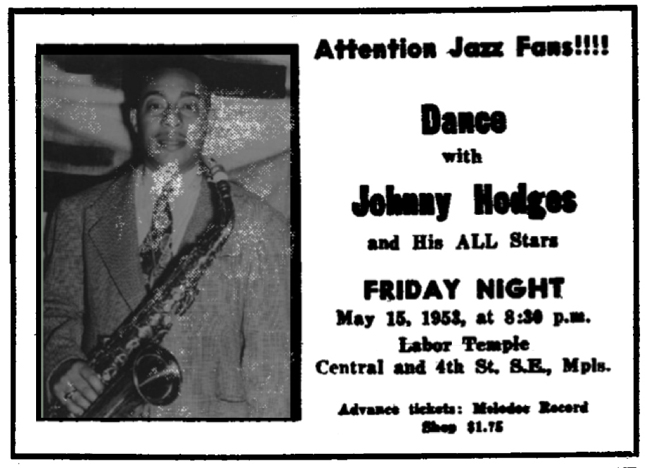
Minnesota Daily ad courtesy Robb Henry
Anna Mae Winburn and Her Sweethearts of Rhythm, May 24, 1953 **
Lowell Fulson, Lloyd Glenn and His Orchestra, May 30, 1953 **
James Moody and His Orchestra, June 19, 1953 **
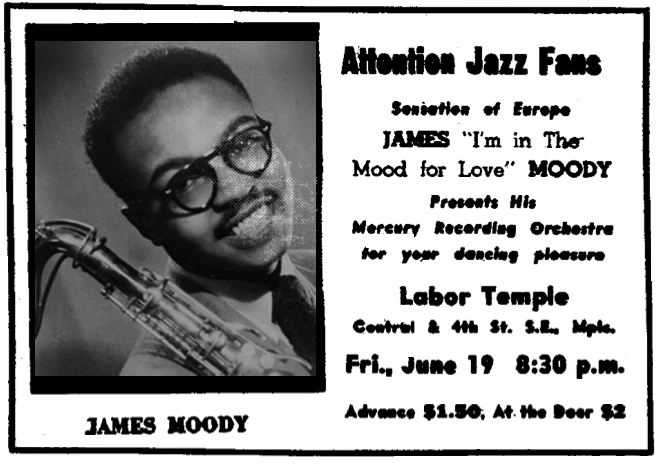
Minnesota Daily ad courtesy Robb Henry
LOUIS JORDAN
Louis Jordan (“The Man Who Sings the Blues”) and His Tympany Five appeared for a dance on July 1, 1953 ** Jordan was extremely popular in the ‘Cities, having already appeared on:
- November 24, 1952 at the St. Paul Auditorium
- April 12, 1953, at “The Biggest Show of ’53” at Radio City with Ella Fitzgerald, Frankie Laine, Woody Herman, and Dusty Fletcher
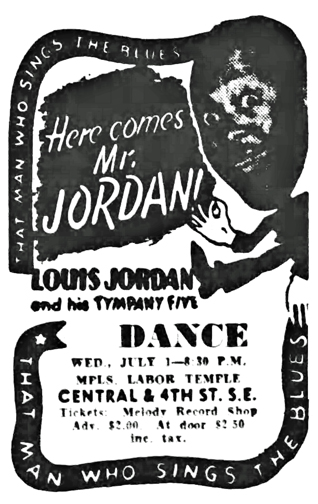
Minneapolis Star, June 1953
Percy Mayfield and His Orchestra, July 3, 1953 **
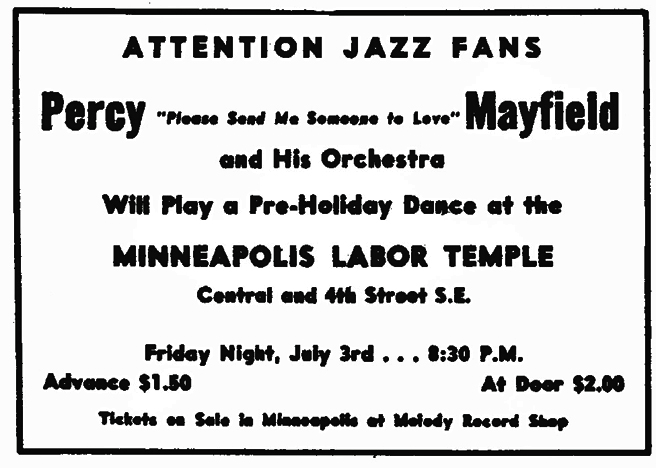
Minnesota Daily ad courtesy Robb Henry
The Clovers with Eddy Boyd’s Orchestra, July 11, 1953 **
Todd Rhodes (“Trying”) and His Orchestra – first time in Minneapolis since his Meteoric Rise in the Juke Box Field – Ellis Attractions
Roy Milton and His Orchestra featuring Camille Howard, August 2, 1953 **
Dinah Washington and Her All-American Trio, August 15, 1953 **
Earl Bostic and His Orchestra, September 5, 1953 **
DUKE ELLINGTON, September 18, 1953. **
Ellington’s band included 15 men and three vocalists, and his program included original compositions such as “Mood Indigo,” “Liberian Suite,” and “Perfume Suite.” Earlier in the day he planned to visit the Sister Kenney Institute and be interviewed by Jack Thayer on WTCN-TV. (Minneapolis Tribune, September 13, 1953)
Amos Milburn, September 19, 1953 – first appearance in the Twin Cities by request of many dance fans. **
Johnny Otis and His Orchestra, featuring Marie Adams, October 3, 1953 **
Preston Love, “The Happy Boy with the Horn” and His Orchestra, October 25, 1953 **
Tiny Bradshaw, Rhythm “King” of Kings on Records and soloist Big Tiny Kennedy, November 27, 1953
5 Royals and Charlie Ferguson’s “All-Girl” Orchestra, December 26, 1953 **
1954
Shows with an * were promoted by D. P. Black.
The Clovers, January 22, 1954 *
Johnny Ace and His Orchestra featuring Willie Mae “Big Mama” Thornton, Blues Singer Supreme, February 19, 1954
Roy Milton and His Solid Senders, featuring dynamic vocalist Lillie Greenwood and Johnny Rogers, the Wizard of the Guitar, February 26, 1954 (annual appearance) *
The Orioles, March 4, 1954 *
“Blues Sensational” Lowell Fulson and His Orchestra – “The Big Hit in Swing Jazz in the Biggest Musical Entertainment of the Spring Season,” March 19, 1954
Johnny Otis and His Orchestra featuring Marie Adams, March 26, 1954 *
Cootie Williams and His Orchestra featuring Eddie “Mr. Clean Head” Vinson, March 30, 1954 – “This is the Dance!” *
Red Allen and His Orchestra, Easter Matinee Dance *
Dinah Washington and Orchestra Matinee Dance, May 2, 1954 *
Ruth Brown, May 12, 1954 *
T-Bone Walker and Checker Campbell’s Orchestra, May 23, 1954 *
Todd Rhodes and His Orchestra, May 28, 1954
Faye Adams with Joe Morris and His Orchestra, June 18, 1954 *
Amos Milburn and Choker Campbell’s Orchestra, July 9, 1954 *
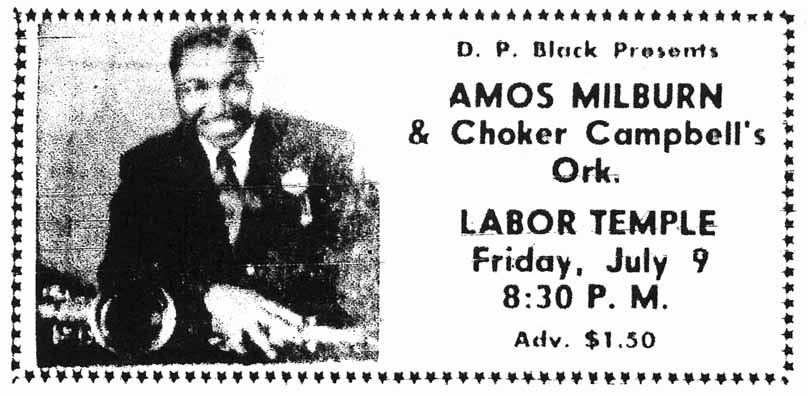
Minneapolis Spokesman
The Ravens, July 24, 1954 *
The Spiders and Memphis Slim’s Orchestra, August 28, 1954 *
Eddie “Mr. Cleanhead” Vinson and the Cootie Williams Orchestra, September 3, 1954 *
The 5 Royals with Tab Smith’s Orchestra, September 18, 1954 *
Jimmy Coe and His Orchestra, November 6, 1954 *
BIG JAY McNEELY BENEFIT
On November 7, 1954, a benefit dance was held to raise funds for Big Jay McNeely and his band, who lost all their instruments, music, and clothing at a fire at Vic’s and were left stranded in Minneapolis. The benefit was organized by A.B. Cassius, who hoped to raise enough to get the musicians back to their homes and “maybe make a down payment on some new instruments.” (Minneapolis Spokesman, November 5, 1954)
Will Jones reported:
Musicians from all over town will work free to provide continuous music from 4 pm to 1 am. There have been donations by bartenders, cooks, waters and other bar and restaurant workers and their unions. Meanwhile, there’s been some doubt whether Big Jay’s group will be on hand for the event. They’re busy lining up one-nighters to keep themselves busy – with borrowed instruments. Only McNeely’s saxophone was saved from the fire. He keeps it with him all the time.
Roy Milton and His Orchestra featuring dynamic vocalist Lillie Greenwood and Johnny Rogers, Wizard of the Guitar, November 28, 1954 *
1955
Shows with a * were promoted by D. P. Black.
Bullmoose Jackson, February 17, 1955 *
King Kolax and His Orchestra, direct from the East Coast, March 25, 1955
Percy Mayfield and His Orchestra, April 1, 1955 *
B.B. “Blues Boy” King and His Orchestra, April 11, 1955
Sonny “Long Gone” Thompson plus Lulu Reed, April 30, 1955
Ruth Brown, Griffen Brothers, May 26, 1955 *
Choker Campbell and His Orchestra featuring Lowell Fulson and his Guitar, October 23, 1955
Tiny Bradshaw and His Orchestra featuring “Little” Tiny Kennedy, October 28, 1955 *
Gene Ammons and His Orchestra plus the Spaniels, November 26, 1955 *
1956
Shows with a * were promoted by D. P. Black. By the way, the story about the May 27 scramble below, gives us about the only clue about the mysterious D.P. Black. It names Patricia Black of D.P. Black Presentations, 3619 Portland Ave. This may have been Patricia’s home address, though (they did that all the time in the newspapers) – it’s a duplex built in 1924.
Drifters and Willie “I Don’t Know” Mabon, January 1, 1956 *
WLOL RECORD HOP
Will Jones:
WLOL Disk Jockeys seem to think some of their listeners don’t get enough of the top 40 tunes during the week. So they’re promoting a Disk Jockey hop in the Labor Temple on Saturday night. They’ll charge the fans admission to come watch them play the same records they play all week for free. There will be some live rock-and-roll music by a group called the Big Five Mellowmen.
This great event took place on April 21, 1956!
DANCE HALL ROCK ‘N’ ROLL: BOOTH ROCKS AND COINS ROLL
The Midnighters with Cal Green’s Orchestra, May 27, 1956. *
Turns out the band’s bus broke down en route from South Bend, Indiana, and the 5:00 dance was delayed for hours. Suddenly the ticket booth, manned by Carl Cockrell, was upended and at the end of a mad scramble, $115 was missing from the till. Cockrell blamed the melee on a few “energetic youngsters,” not people wanting refunds. Finally the musicians arrived and “broke into the rollicking beat of ‘Dance if You Want to Dance.’ The customers did, until midnight.” (Minneapolis Star, May 28, 1956)
Ernie Freeman and His Orchestra Plus the Coasters, July 21, 1956 *
Ray Charles and His Orchestra, August 21, 1956 *
Tiny (Mr. Soft) Bradshaw and His Orchestra, Added Attraction “Mr. Bear.” Biggest Ball of the Year – Minnesota-Iowa Shriners Potentates Ball, September 1, 1956
Jay McShann and Priscilla Bowman, September 8, 1956 *
Charles Brown and His Orchestra, November 16, 1956 *
Bill Haley and His Comets – date unknown, but David Anthony Wachter says the show was promoted by T. B. Skarning.
1957
FRENCHY’S MISADVENTURE
This is the unfortunate story of Lee Thomas “Frenchy” Speicher, whose “real cool” calypso and rock ‘n’ roll dancing at the Labor Temple got him captured on a murder charge.
It all came down this way. It was July 4, 1957, and Frenchy was at North Commons watching the fireworks. An acquaintance named “Lucky or Bucky” came up and asked him if he knew where to get some whisky, so he asked three fellows if they had any for sale. They said yes, took $5 from Lucky, went to their car, but they drove away. Frenchy gave chase, and when the three guys stopped, Lucky went at them with a club.
Frenchy got out and, “as a show of strength,” showed the men in the car his nine-millimeter German luger. As he cocked it, the gun went off, and a bullet went through Robert Varnardo’s neck: a wound that would kill him. The bullet then through Earthia B. Wiley’s arm, into his side and lodged in his back. Frenchy drove Lucky to Lyndale and Wayzata Blvd., then tossed the gun into the Mississippi River near Brooklyn Center.
How they caught Frenchy is a great story. Detective Inspective Charles Wetherille remembered that the dances were operated by a woman who rented the hall (probably Pat Black). From the description of the third man in the car, Black suspected a man she knew only as Frenchy. She did remember that Frenchy’s picture had been in the Minneapolis Star in a story about a “jive session” the previous September. Wetherille contacted the author and the photographer of the story, which turned out to be a review of a Ray Charles concert and dance. The photographer had taken a front shot of Frenchy dancing, but Frenchy asked him to “keep his mug out of the paper.” So the photo appeared with Frenchy’s partner facing the camera.
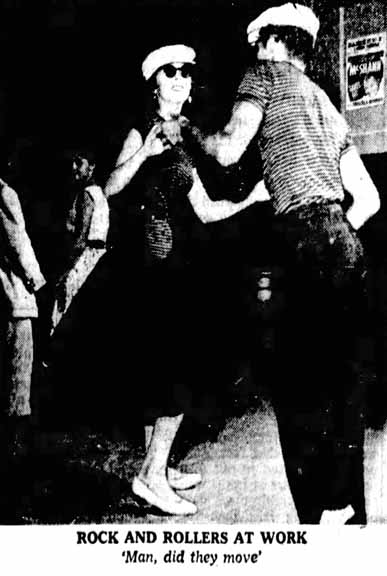
Minneapolis Star, September 3, 1 956
But the photographer still had the head-on photo on file, and voila! A photo of Frenchy’s face. Wetherille requested a dozen copies and distributed them to detectives. One got a tip, and at 3 am on July 6, Frenchy got rousted out of bed and brought to headquarters.
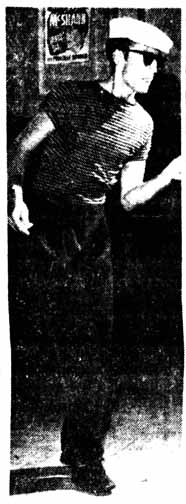
Minneapolis Star, July 6, 1957
Once at the station, Frenchy admitted he had the gun, but swore it was unloaded, and that “someone grabbed it and it went off. I don’t know how the bullet got in there.” He was charged with first degree manslaughter, but on the day his case was to go to trial (September 9, 1957), he pled guilty to second degree manslaughter. On November 25, 1957, he was sentenced to a year in the workhouse and four years probation.
A bit more on Frenchy: he was born in 1931 in Milwaukee, and served as a paratrooper in Korea beginning in 1951. He was working as a telephone repairman at the time of the shooting, and was married. He loved to dance! During his jailhouse interview he admitted that he was a “real hot dancer” in the style known as “cool.” “I just go into a frenzy … and I don’t have to get drunk to get that way,” he said. He was temporarily reported missing during the 1965 Fridley tornado, but lived until 1983, when he died in Alaska. He is buried at Fort Snelling.
Here’s to Frenchy, the coolest dancer at the Labor Temple, 1957.
LOUIS JORDAN RETURNS
Louis Jordan brought his sextet to town on July 28, 1957. * It was a matinee dance, from 5:30 to 9:30 pm; travel requirements for a date in Seattle dictated the early time. This was his first appearance in the Twin Cities since he organized the small group, which featured Jackie Davis on electric organ, and Austin Powell on guitar. (Minneapolis Tribune, July 25 and 28, 1957)
1958
Percy Mayfield performed at the Labor Temple on July 3, 1958.
1958 – 1968
During this time it doesn’t appear that there were many, if any, musical events at the Labor Temple. Most of the articles that popped up were for Golden gloves boxing bouts.
1966
The Minnesota Committee to End the War in Viet Nam booked the Labor Temple for a rally for March 26, 1966. Scheduled to speak were Mulford Q. Sibley, professor at the U of M; Paul Krassner, editor of Realist magazine; Fred Stover, editor of U.S. Farm News; and Sidney Lens, a Chicago journalist.
After a great deal of pushback from union members, many of whom had sons serving in Vietnam, the reservation was cancelled. Larry Seigle, Chairman of the Committee, was told that the Labor Temple was open to all groups, but not to “Communistic groups.” The rally was moved to the Unitarian Society, where a spokesman said they viewed the transaction as an “ordinary rental.” (Minneapolis Star, March 21, 1966) The political cartoon below appeared on the Star’s opinion page.
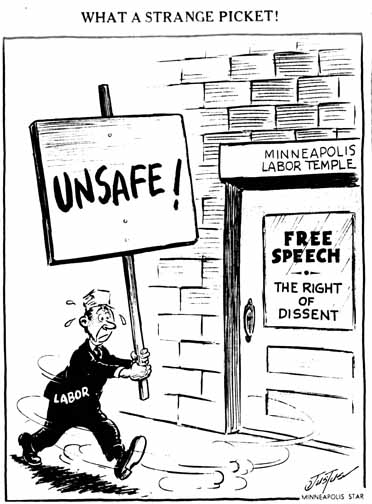
Minneapolis Star, March 21, 1966
1967
PREACHER DIRECTS WRATH OF GOD AT LABOR TEMPLE
Another cancellation made waves, but in a different direction, in 1967. Rev. Dr. Carl McIntire was a controversial radio preacher from Collingswood, New Jersey. His “Twentieth Century Reformation Hour” was heard on 600 radio stations, and his message was fighting creeping Communism, which in his mind took the form of the War on Poverty programs and the “new morality.”
His reservation at the Labor Temple was cancelled, and he relocated to the Armory, where he drew about 500 people on May 5, 1967. There, he accused Minneapolis of being soft on Communism. “Somebody tells me Minneapolis sent a trade delegation to Moscow. What’s wrong with you people?” And, “What this country needs is not more political and social action and socialism.” (Minneapolis Star, May 6, 1967)
THE HIPPIE ERA
After a considerable lull, music reappeared at the Labor Temple, this time with a completely different cast of characters. Although a lot of the music that the young people of the 1960s were listening to was based on American Rhythm & Blues, one wonders whether they knew of the amazing artists who had performed under the same roof in the ’40s and ’50s.
FILLING A NEED
The closest venue to compare to the Labor Temple was Dania Hall on the West Bank, where concerts and dances had been held for several years. But few of these were advertised, so it’s difficult to document when they were or which bands were featured. In general they were probably not regularly scheduled, and usually featured favorite local groups, especially the Paisleys. Dania Hall was a much smaller venue, and the search was on for a place where bigger groups and larger audiences could be accommodated.
COMMUNITY NEWS
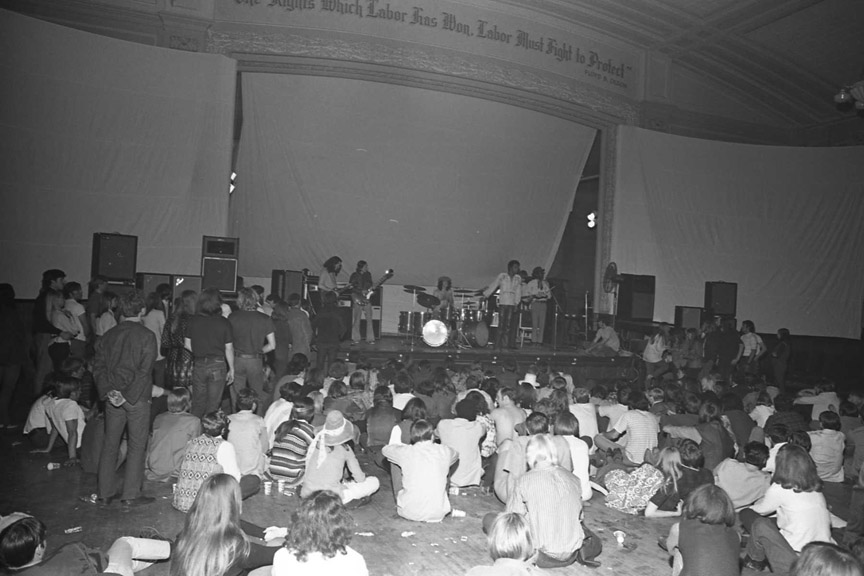
Photo Courtesy Mike Barich
The first set of concerts were “Presented by Community News,” a group headed by Charlie Campbell. After graduating from White Bear Lake High School in 1965, Charlie traveled to California where he “interned” with a group called the Magic Theater, an offshoot of the Merry Pranksters. There he learned the psychedelic light show trade.
He returned to Minnesota and started a light show group, Community News, with his brother and two others. One manned an overhead projector, one a slide projector, one did the requisite liquid light show with vegetable oil and food coloring (the trick is in the concave clock face), and Charlie had the movie projector. He would check the movies out of the public library – some art films mixed with some Busby Berkley and cartoons.
Charlie:
Our first gig was with the High Spirits at Coffman Memorial Union at the U of M, on May 19, 1967. After realizing that the bands at the time didn’t see the value of splitting their fee with a light show group, I concluded that we needed to put on our own shows and hire the band. We started our run at Dania Hall on the West Bank, which was perfect, in the fall of ’67. The bands we worked with were Noah’s Ark, TBI (True Blues Incorporated), Pandemonium Side Show, Mill City Blues Band, Jokers Wild, and the Litter among others. The Paisleys, with a competing light show, played every other week. It was after a Jokers Wild show there in December ’68 that their manager, Dave Anthony, lamented that there wasn’t a bigger venue to handle the crowds (we were over capacity at Dania) that we revealed our discovery of the Labor Temple.
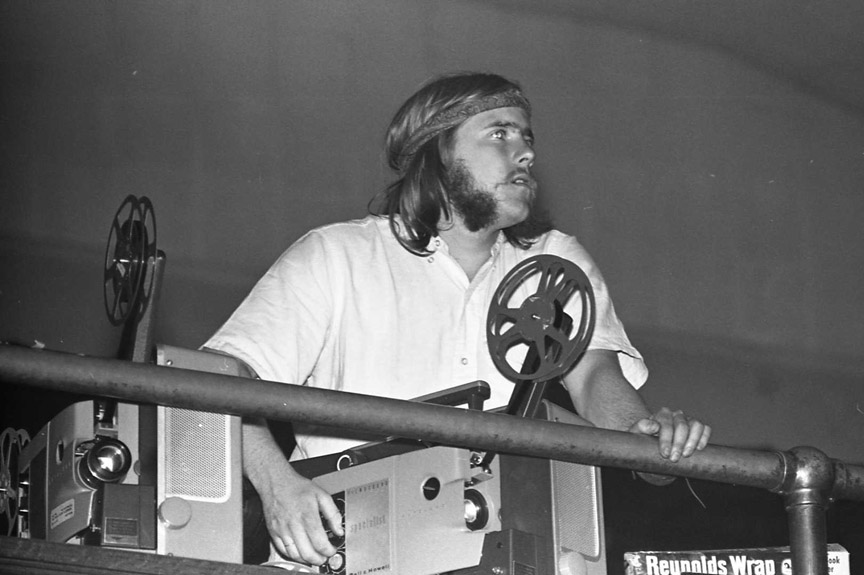
Charlie Campbell. Photo copyright Mike Barich
The photo below (from the Spirit show) gives a balcony-eye view of the scene below.
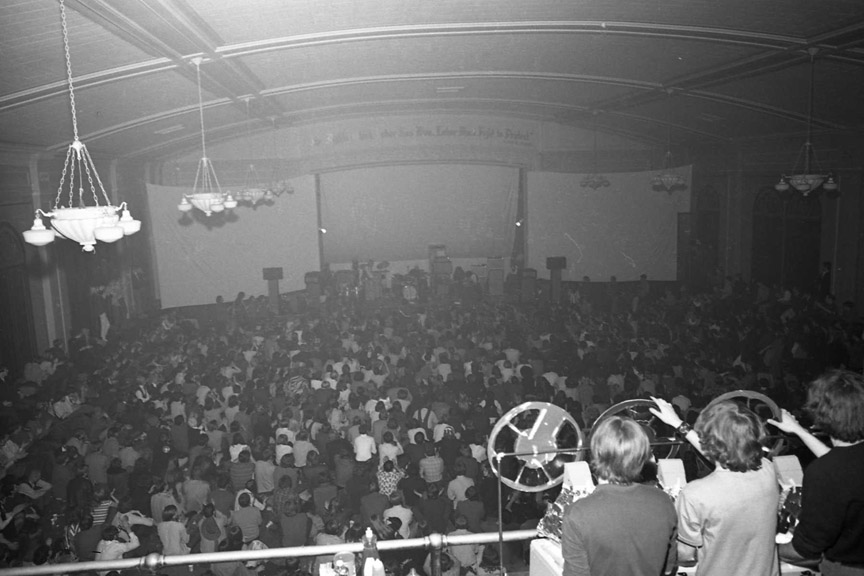
Photo Copyright Mike Barich

DAVID ANTHONY
David Anthony was a major music promoter and agent in the ’60s. The owners of the Labor Temple wouldn’t rent to a long-haired hippie freak like Charlie, but they would do business with David, so David hired Community News to do the light shows and handle the tickets and posters. In 1969 he started booking national psychedelic acts, some of which were not all that well known yet and couldn’t fill one of the bigger halls. Anthony was easy to find at shows, as he was the only one in a three-piece suit!
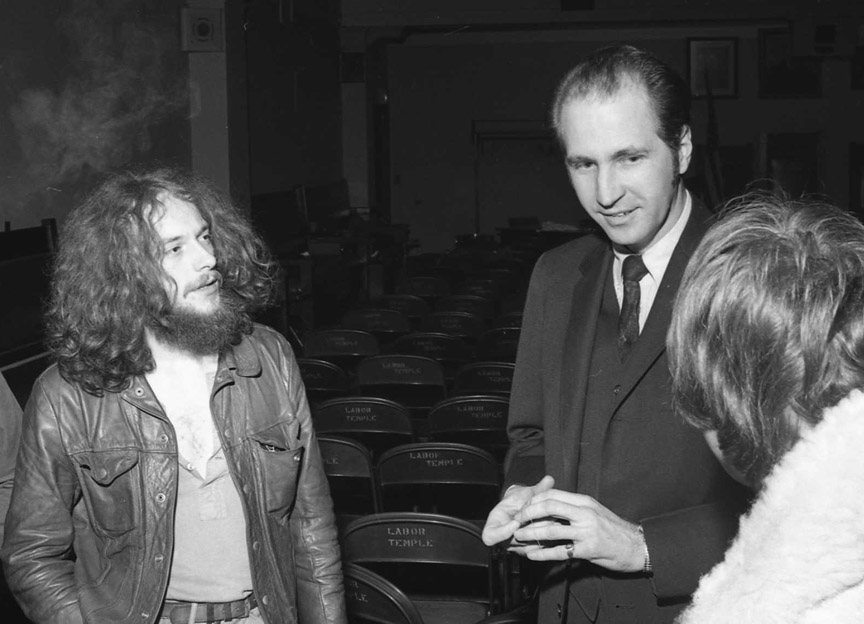
David Anthony with Jethro Tull – Photo Copyright Mike Barich, St. Paul
The very first Labor Temple Concerts in 1969 were only affordable because David Anthony was able to get the groups in to town on Sundays after playing weekends in Chicago at Russo’s Kinetic Playground. On the poster below, notice the dates of the weekend performers and compare them to the Sunday night show at the Labor Temple:
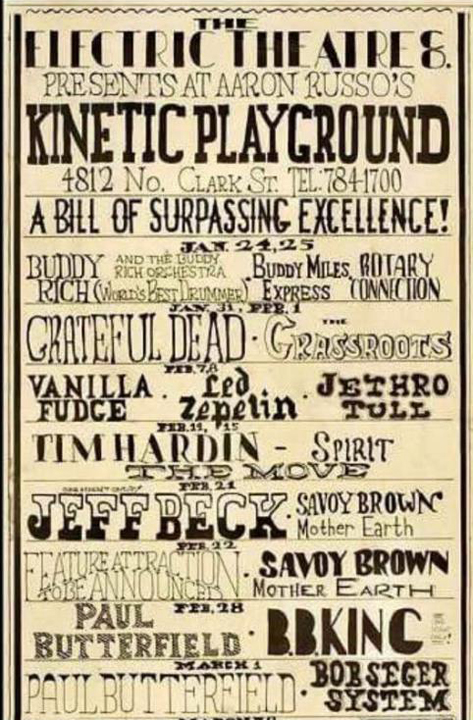
Kinetic Playground Poster courtesy GoJohnnygo.com
Grateful Dead:
Jan 31-Feb 1 Russo’s Kinetic Playground
Feb 2 Labor Temple
Jethro Tull:
Feb 7-8: Russo’s Kinetic Playground
Feb 9: Labor Temple
Spirit:
Feb 19: Russo’s Kinetic Playground
Feb 16: Labor Temple
Mother Earth:
Feb 22: Russo’s Kinetic Playground
Feb 16: Labor Temple
Anthony said he paid between $2,000 and $5,000 for an act, and priced tickets accordingly. Unfortunately, all of Anthony’s archives were destroyed – imagine what he might have had!
Labor Temple shows were held almost every Sunday night during its run, except during the hot summers). It was stressed in most reviews that this was the first venue in Minneapolis where there were regularly-scheduled rock concerts – something that had been sorely needed. Many compared the venue to San Francisco’s Fillmore West in that regard.
GENERAL NOTES:
- Concerts were on the third floor of the hall. Hauling those Hammond B3s up those marble stairs was a bitch.
- Above the stage was inscribed the quote, “ “Those rights which Labor has won, Labor must fight to Protect.”
- The Manager of the Labor Temple was John Bruchard.
- Anthony hired five off-duty police officers, who generally had nothing to do; one article characterized concert-goers as “lovers, not fighters.”
- The main floor had chairs along the sides; the middle was open for sitting, standing, dancing, enjoying the music.
- The balcony had chairs.
- The capacity was 1,250.
- Posters were created by Juryj (“George”) Ostroushko. Many images can be found on his website.
-
Other poster images are courtesy of poster collector and auctioneer Paul Pash.
- Most of the Minneapolis Star and Tribune ads below are courtesy of Mike Jann.
- Robb Henry had the foresight to capture ads from the Minnesota Daily while it was online; it has disappeared since. I deeply appreciate Robb’s sharing his scans with me to post. See a collage on Robb Henry’s blog.
CONCESSIONS
The concession stand was often manned by Gregg Inhofer and Bobby Strength of Pepper Fog (below). An unusual offering was tangerines for 25 cents. No alcohol was sold.
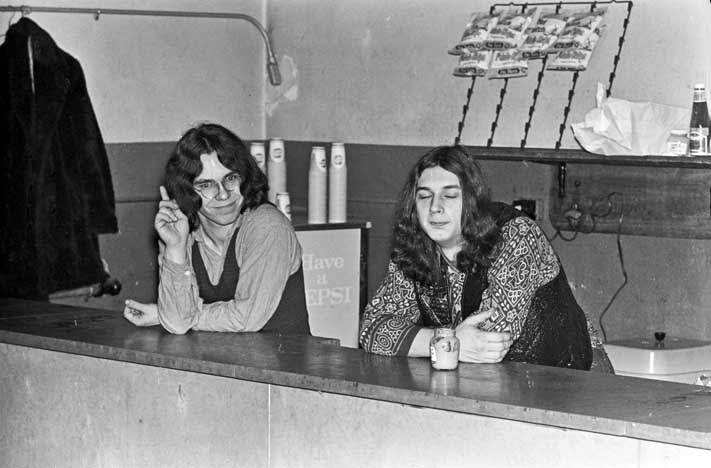
Gregg Inhofer and Bob Strength before the Savoy Brown show – Photo Copyright Mike Barich
Discount Records sold LPs in the building at some shows. The photo below is from the Spirit show.
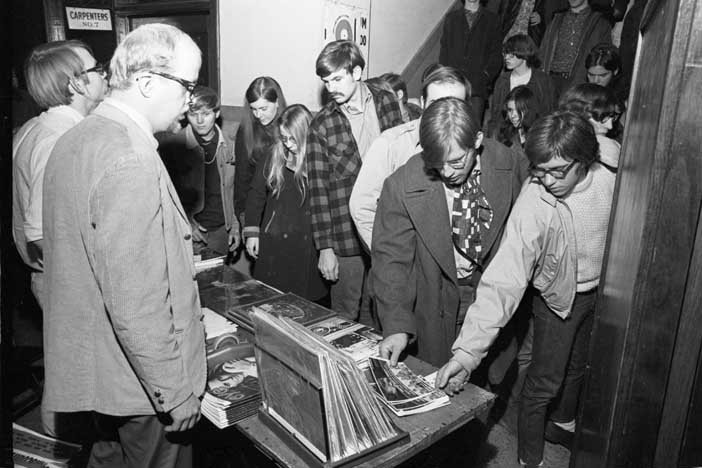
Photo Copyright Mike Barich, St. Paul
MIKE BARICH
Most of the photographs you see here were taken by Mike Barich, the staff photographer for Connie’s Insider magazine. In 2019 into 2020 (and ongoing), David Roth of tpt has been scanning Mike’s negatives, most of which have been stored in Mike’s basement for 50 years. Mike has generously allowed me to post them, for which I thank him profusely. I have not watermarked them, as watermarks can be removed, but I only post all of my photos at 72 dpi – a low enough resolution so that they can’t be grabbed and sold. We owe Mike a huge debt of gratitude for taking these photos and preserving the negatives over the years. And a huge thank you to David for taking on the gargantuan task of scanning these thousands of negatives, starting with the Depot for his documentary on the 50th Anniversary of First Avenue in April 2020, and then the Labor Temple, my favorite venue!
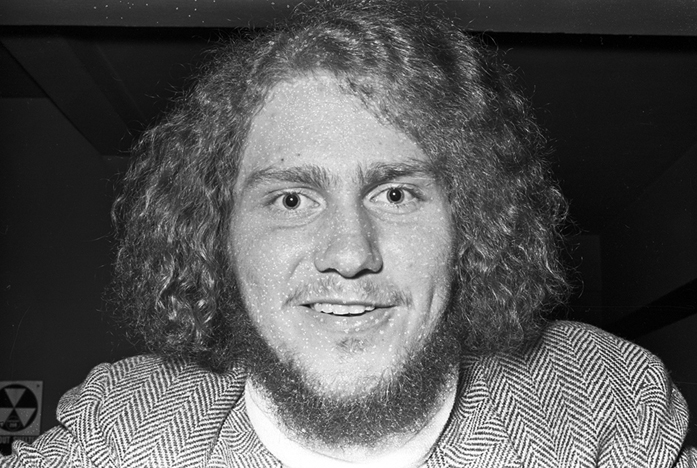
Mike Barich in 1970 – Photo copyright Mike Barich
MARSHALL FINE
Many of the reviews you will see here were written by Marshall Fine while he was a theater student at the University of Minnesota; his reviews were published in the Minneapolis Star. Fine honed his journalism skills at St. Louis Park High School (my alma mater!), working on the school paper, the Echo. His career skyrocketed, bringing him to New York City as a major film critic. Highlights of his impressive resume can be seen on the St. Louis Park Historical Society website.
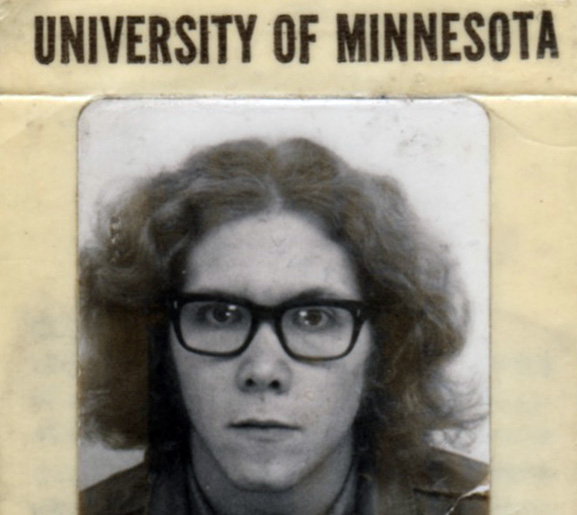
Marshall Fine’s 1972 U of M ID, courtesy Marshall Fine
THE FIRST PRESS
CONNIE’S INSIDER
As usual, Connie Hechter, publisher of Connie’s Insider, was Johnny-on-the-Spot, reporting on the new venue in the January 25-February 1, 1969, issue of his music magazine.
TEMPLE TO FEATURE TOP UNDERGROUND ACTS was the big headline of the issue. David Anthony was quoted: “We will concentrate on booking the top underground talent in the country, and we hope to eventually open on Friday and Saturday nights too, using local-regional talent as well as national acts.”
MINNEAPOLIS TRIBUNE, January 26, 1969
Entertainment columnist Mike Steele:
Another attempt at a Twin Cities underground rock – blues ballroom will open Feb. 2 in the Minneapolis Labor Temple, 117 SE 4th St. David Anthony, a local booker of pop music groups, will do the booking for the producers of the hall, Community News, former producers of Dania Hall concerts. It will be called The Temple and open with Sunday concerts only, running from 8 pm to midnight. The Grateful Dead will play the opener, followed Feb. 9 by The Rotary Connection and Jethro Tull. Others on the schedule are The Spirit, Jeff Beck, Ten Years After and the Who. Tickets are $3.50.
SHOWS AT THE LABOR TEMPLE: 1969 – 1970

Insider, January 25 – February 1, 1969
GRATEFUL DEAD AND BLACKWOOD APOLOGY – February 2, 1969
Allan Holbert wrote a column of the impending opening concert at the Temple on February 2, 1969. “Big time rock action begins for the first time in Minneapolis on a regular basis with a combination concert and dance (or whatever you want to do).”
He described the groups to be presented at the Temple as “either nationally known underground rock groups or groups that are just starting to break into the big time.” He reported that David Anthony was to be president of Community News when it became a corporation. (Minneapolis Tribune, February 2, 1969)
Anthony was quoted as such:
We’ll have the Community News light show and people will just come in and mostly sit on the floor in little groups and groove with the music. What we want to achieve is an intimacy you just can’t get in a big hall like the Minneapolis Auditorium or the Armory.
The atmosphere’s just wrong in those big places. There’s the act and there you are and there’s no real good relationship between the audience and the act.
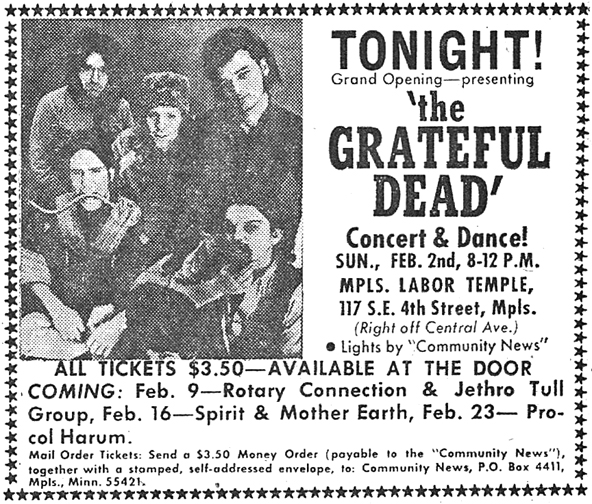
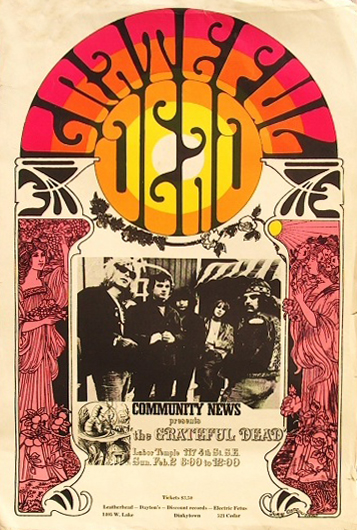
Poster image courtesy Charlie Campbell
The Dead arrived with an iguana, a rooster, goat, snake, and three kids. Although it was 25 below zero and tickets were an onerous $3.50, the people came.
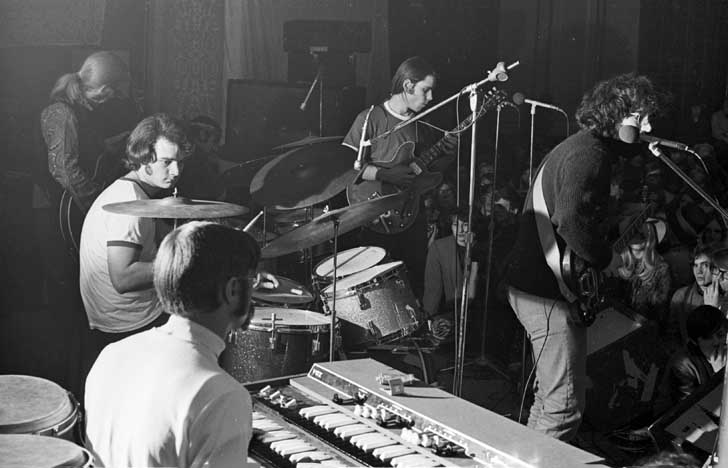
Grateful Dead – Photo Copyright Mike Barich, St. Paul
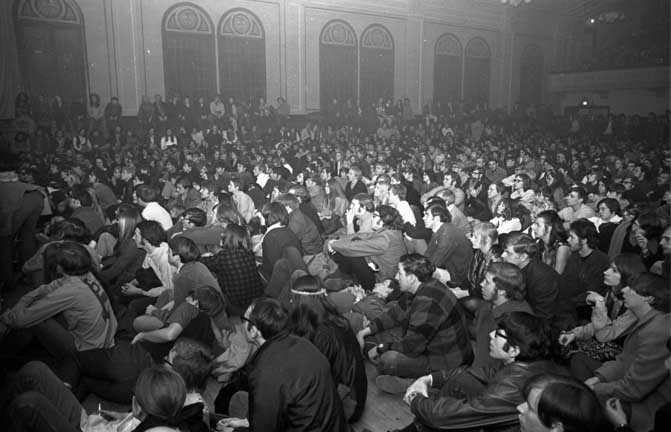
Crowd for Grateful Dead – Photo Copyright Mike Barich, St. Paul
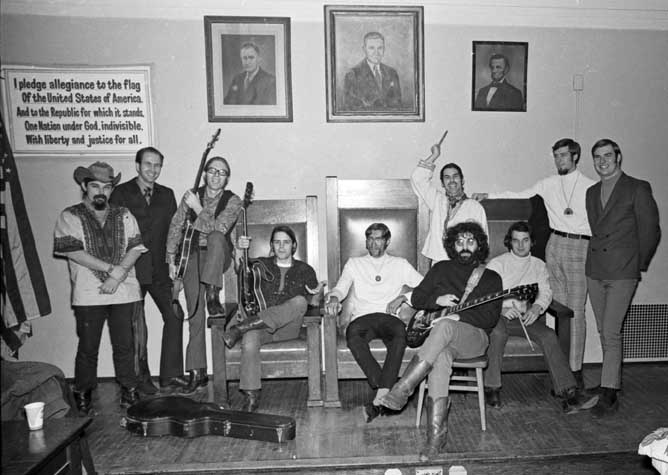
Grateful Dead and friends – Photo Copyright Mike Barich, St. Paul
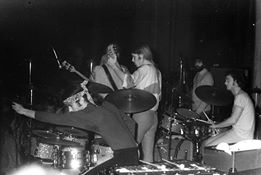
Photo by Gary Schwartz
MINNEAPOLIS TRIBUNE (no byline), February 3, 1969
GRATEFUL DEAD SOCK IT TO 2,000 MUSIC LOVERS
The Labor Temple was packed. The audience, mostly late-high-school and college-age youth, completely filled the chairless main floor, sitting or standing. And all other seats and aisles were taken in the balcony.
As a preliminary to the Grateful Dead, a local group called the Blackwood Apology held forth for an hour or so with the same sort of electric sound. It came on like just what it was: hundreds of watts of electrified musical power pounding out of great stacks and racks of amplifiers.
And above, lights flashed multicolored, changing images of psychedelia on great wide screens. Making it happen was the Grateful Dead, a group billed as the leader of underground rock, as the nationally famed but uncompromised original.
The more than 2,000 young people who jammed the Minneapolis Labor Temple to hear them Sunday night took it quite coolly. They liked it, they clapped a lot, and some of them danced. But mainly, they did what you do with this kind of youth art: They experienced it.
After a long delay for setting up their nearly 100 pieces of equipment, the Grateful Dead came on with a sound like the end of a bad trip. It was a horrendously penetrating hum from an amplifier gone mad. But when they got the amplifier squared away, they showed that they can play as well as make noise. Using some incredibly complex tempos and fine improvisations, they did the mixture of jazz and rock and folk that – along with the lights and, in some cases, marijuana – has been turning on people around the country for several years.
MINNEAPOLIS STAR, February 3, 1969
Johan N. Mathiesen was identified as a Minneapolis writer and critic. For sure he was a fan of the Grateful Dead! Jerry Garcia’s guitar was “deft and lyrical.” Phil Lesch’s bass was “wandering, penetrating.” “Add to that the complex beats of two excellent drummers and you have the finest rhythm section in all of rock and probably beyond.” The performance was “worthy of such rock emporiums as San Francisco’s Avalon or the Fillmore West.” And “despite nearly unbearable heat, they had everyone in the place bouncing and screaming for more.”
As for the venue itself, he gave it a “triple-A rating,” but agreed that it was too small, at least for that particular show.
And as for the opening act, Blackwood Apology somehow became Black Widow Apology in his review. That was the first and last review I’ve ever seen from Mr. Mathiesen.
MINNESOTA DAILY, February 7, 1969
Tim Boxell was impressed by the “massive turnout” and mused, “This may just be what Minneapolis needs.” Boxell wasn’t impressed with the Dead’s music or efficiency in setting up, but liked the venue, although it was way too small for the crowd that showed up.
The market for this sort of entertainment is here, and David Anthony has big talent booked for the future. Perhaps now the Twin Cities can see the best groups for less and the bands that depend on audience involvement can succeed.
MINNESOTA DAILY, February 7, 1969
Another review in the Daily by Marshall Fine was enthusiastically titled “Just what Minneapolis Needs.” “Big time rock music has finally made it fulltime in Minneapolis.” He reported that more than 2,000 people had shown up at the venue, “which had a purported capacity of 1650.”
CONNIE’S INSIDER, February 15 – 22, 1969
After only one show, Connie gave the Temple exemplary marks. Connie was a jazz artist, older, and not a “head,” so he was playing catch-up to this new sound.
LABOR TEMPLE DRAWS HEAD MUSIC FANS
The Minneapolis Labor Temple, converted on Sunday eveningss to a temple of the best in “head, underground or and psychedelic” sound, has become to the Twin Cities what the Fillmore and Avalon have become to the West Coast scene, and what the Kinetic Playground has become to Chicago. The Temple is the showcase for the national acts which do their thing within the categor or framework (if any exists) of this kind of sound. (Note: The Twin Cities has long had The New City Opera House, a showcase for the bes in local-regional underground talent, and the possesser of a first rate light show.)
CONNIE’S INSIDER, February 15 – 22, 1969
The review of the Grateful Dead show itself was written by Will Shapira, the Insider’s regular concert reviewer. He noted that the called the show, which drew 1,600 to the “musty old hall” as “memorable and exciting.” He deemed the solo guitar work absolutely first-rate, on the level of the best jazzmen. He called the booking of the Dead a “masterstroke” as their first venture, and they should be brought back in the near future – which they were!
Shapira found the 90-minute set of the Blackwood Apology highly impressive, including some exciting organ work. They generated considerable excitement among the audience, which then “cooled it for about 45 minutes while electronic problems in the Dead’s equipment were straightened out.”
ROBERT BORCHERT
Bob wasn’t a music critic, but a fan who was there that night. Here are his memories:
The first time I saw the Dead was February 2, 1969, at the Minneapolis Labor Temple. I was an Airplane freak at the time but my friends were already Dead Heads with only the limited exposure of the first Warner Bros album and Aoxomoxoa. They saw to it that I came along.
The Hells Angels were overseeing the entry, stationed along the two flights of narrow stairs leading up to the third floor Union Hall where they were lingering about in the wings. The Minnesota Hells probably had 6-8 members but it seemed like dozens. The stage was about three feet above the main floor which had no seating, at least in the front half. The balcony may have had seating, but I never left the “dance floor.” I imagine the balcony as having a heavy curving wooden railing.
The band never really “took the stage.” People were just milling about. Some picking up instruments. I didn’t know who was who. An impressive looking man with very long hair tied back in a pony tail was at a microphone at the front of the stage. He appeared to be testing the sound and speaking in some kind of musical/audio code to an unseen person. “That’s Lesh,” my friend told me. ” He has perfect pitch.”
They gradually worked into a tune and an hour and a half later we had never stopped dancing. I didn’t even know they were a dance band. We figured we must be the best audience they had ever had, not knowing that the camaraderie and electricity between band and audience was standard Grateful Dead fare. Afterwards, if you asked me, I would have said we danced to “Lovelight” the whole night. When Live/Dead came out I realized, “Oh, yah, they played all that and more.”
Over the years I became confused between what I’d actually heard and what was on Live/Dead and began to doubt my own memory of the show. I downloaded the “tape” of the show several months ago and was delighted that I remembered it correctly. It really was Live/Dead and much much more.
Local band Blackwood Apology performed their rock opera “House of Leather” to open.
The photo below is of Blackwood Apology just before going on stage. Pictured left to right are Bruce Pedalty, Dale Menten, Joe Piazza, Dik Hedlund, with Dennis Libby in front.
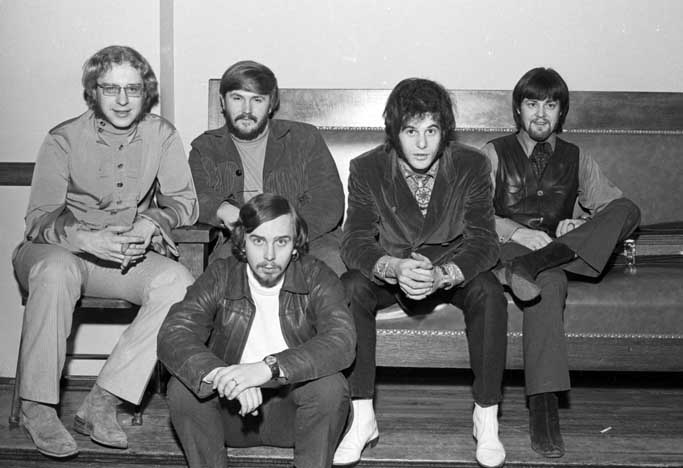
Blackwood Apology – Photo Copyright Mike Barich, St. Paul
JETHRO TULL AND ROTARY CONNECTION – February 9, 1969
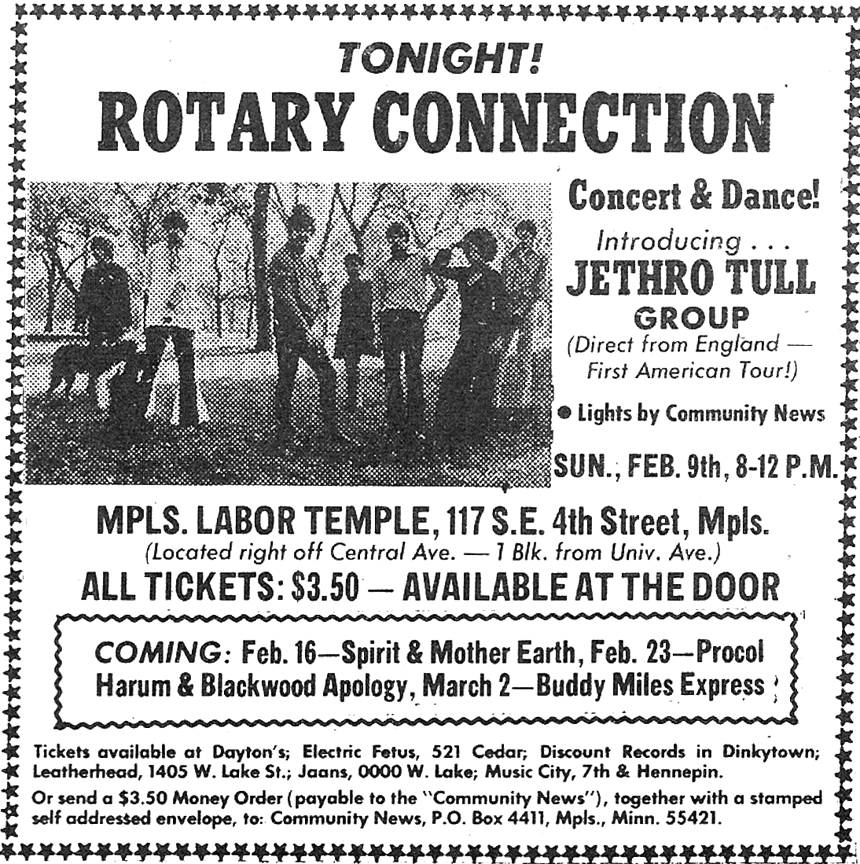
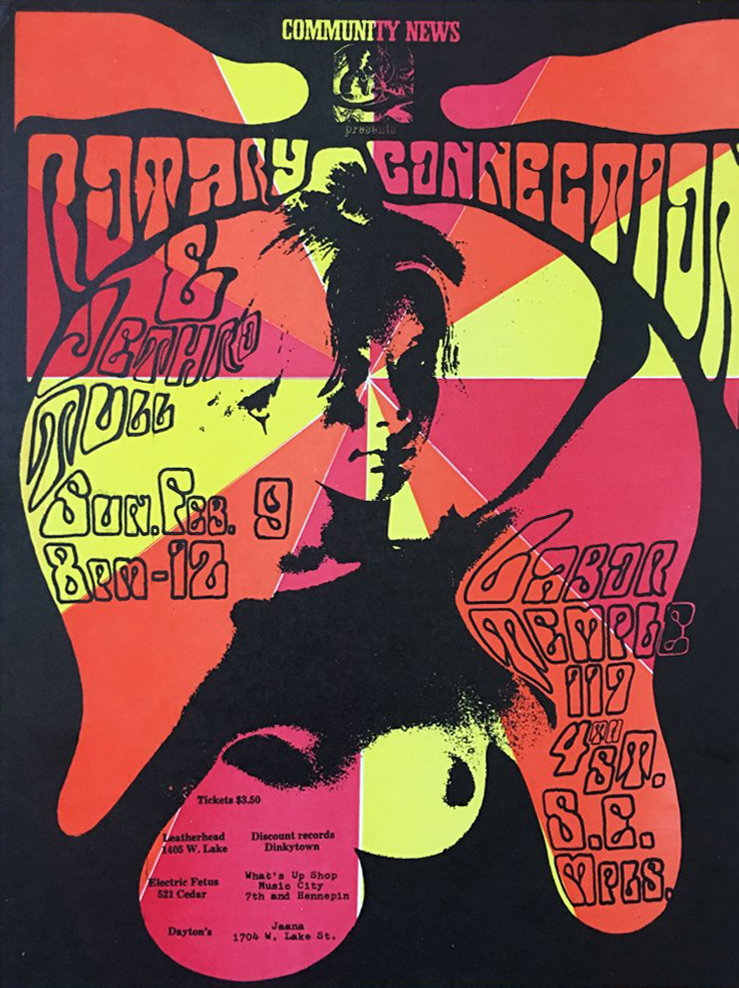
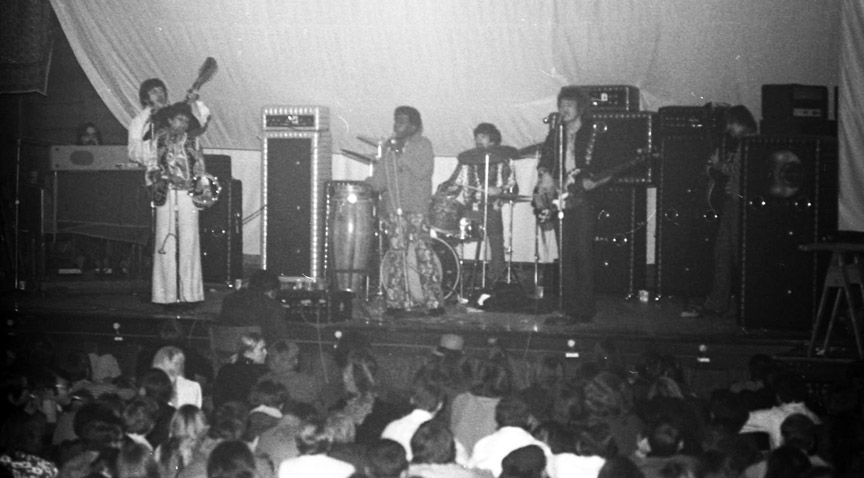
Rotary Connection – Photo Copyright Mike Barich, St. Paul
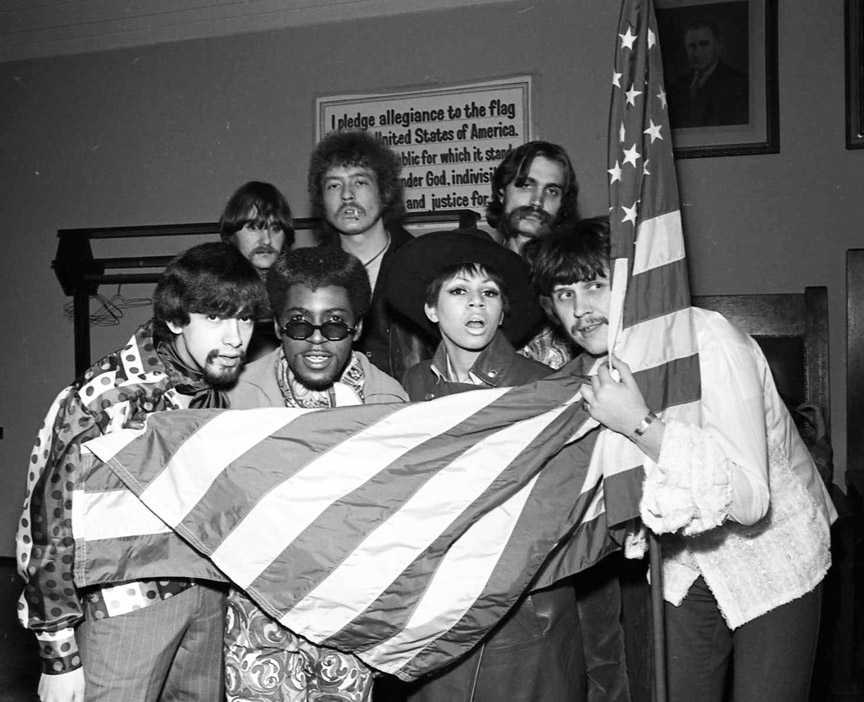
Rotary Connection – Photo Copyright Mike Barich, St. Paul
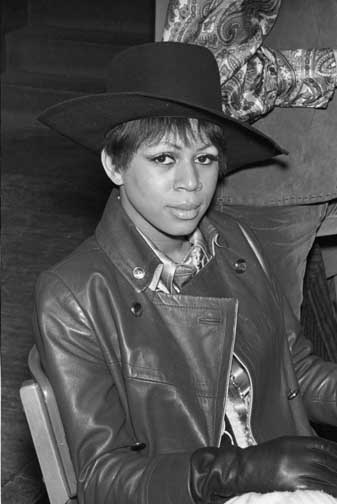
Minnie Ripperton of Rotary Connection – Photo Copyright Mike Barich, St. Paul
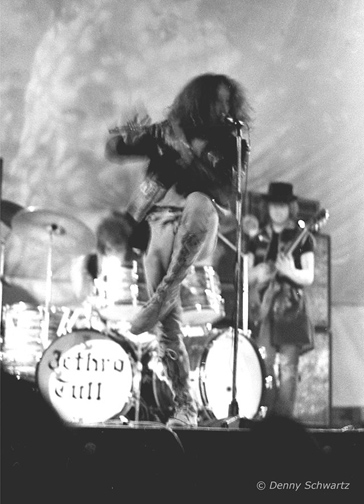
Photo of Jethro Tull Copyright Denny Schwartz
CONNIE’S INSIDER, February 15 – 22, 1969
Will Shapira reported that a good crowd of about 1,000 filled the Temple to hear this four-hour show.
Connection, a six-piece band, pleased the audience with a set of well-rehearsed, always interessting songs, most of which featured the vocalist, Minnie [Ripperton], who somehow is able to do with her voice what John Coltrane did with the soprano saxophone. The lofty sound, over a well-integrated line of organ and guitars, was shrill and exciting, but to some ears tolerable in short bursts only.
This was Jethro Tull’s first American tour and Shapira found him to be “extremely jazz-oriented and talented.” Tull alternated between harmonica and flute, and his solos “swung and soared beautifully.”
During the course of the varied set, Tull and crew presented a jazz flute duet, a transcription for flute of a Bach guitar piece, an extended, solid guitar solo by Martin Barnes, and a rollicking drum solo to close the group’s highly impressive performance.
The most accurate summation of the evening came from Tull himself when he let us in on the current English phrase used to describe a pleasurable occasion or experience: “Supergroovycool!”
WARREN WALSH
As I recall it was another one of those nasty cold Minnesota nights. It was a Sunday night and there couldn’t have been more then a couple of hundred people there. Jethro Tull was just releasing their first album and nobody knew who they were [their first US stop]. We didn’t care much for the Rotary Connection but it beat sitting around on a Sunday evening. We sat on the floor about 10-20 feet from the low stage. Can’t remember the Rotary Connection but Jethro Tull took our heads off! During the break Ian Anderson just stepped down and mixed with the crowd. I remember him sharing some cigarettes with a few of us stand near the front.
SPIRIT AND MOTHER EARTH WITH CLOVER: February 16, 1969
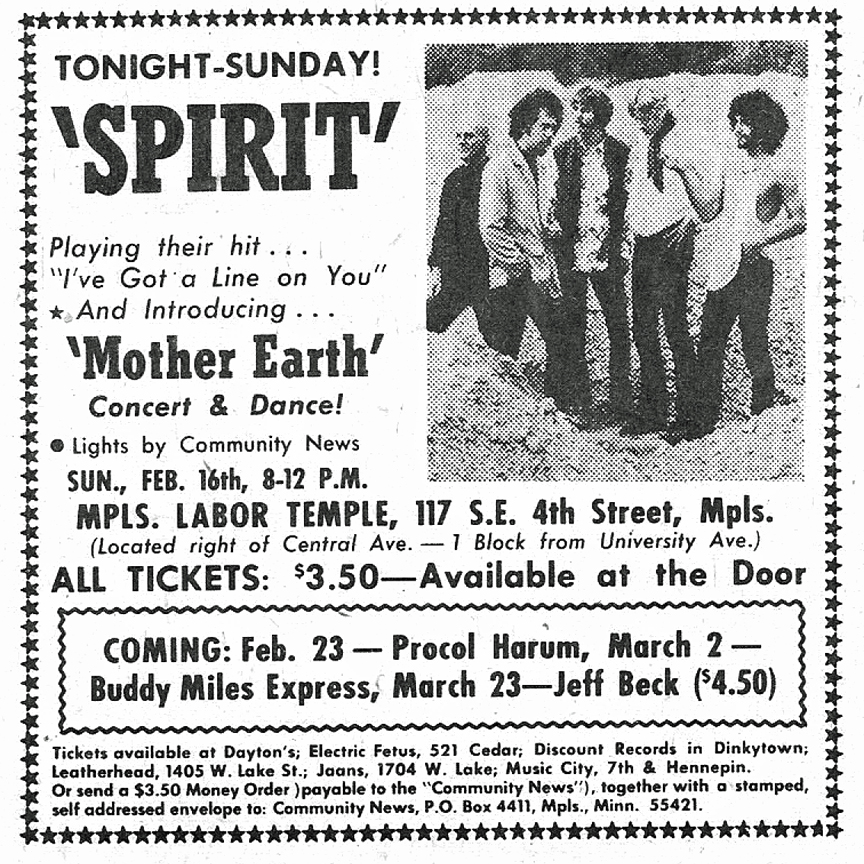

Ad from Connie’s Insider
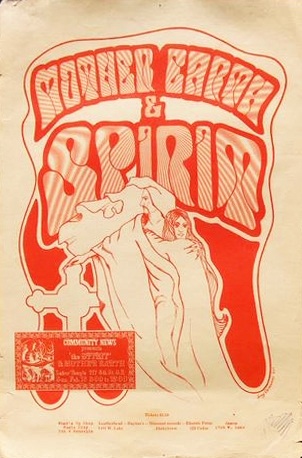
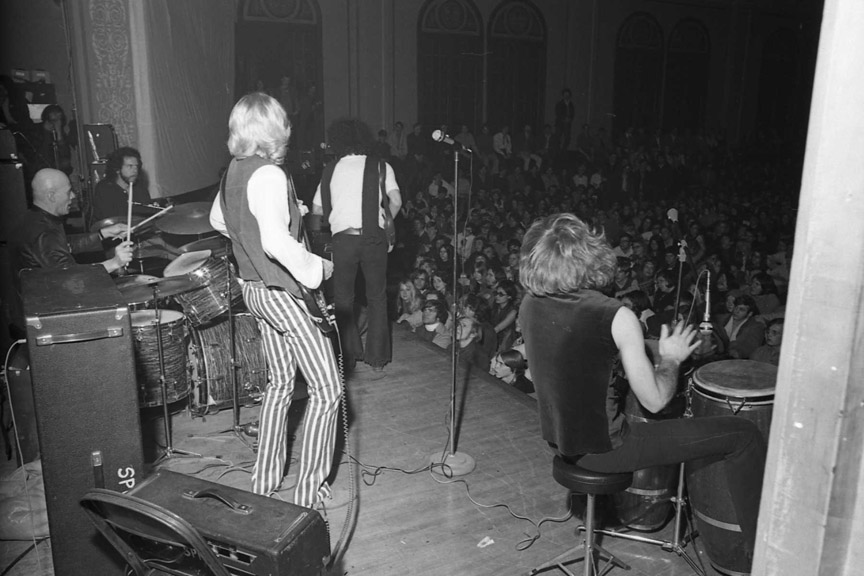
Spirit – Photo Copyright Mike Barich
CONNIE’S INSIDER, March 1 – 8, 1969
Will Shapira noted that it was becoming “squashingly evident” during Spirit’s concert that Anthony and Community News may need a larger hall for their concerts if things continued as they were. A turn-away audience of 1,300 jammed the room.
After running through several of their shorter, better-known songs, Spirit stretched out in an extended suite called “Elijah.” Set in 6/8 time and using a simple but pleasing melody that could have been written by Dave Brubeck, the piece served as a launching pad for extended solo flights by all members of the band. The lead guitarist wanged out some fantasstic, mind-bending electrionic runs which he carried to eardrum-shattering heights, only to switch off completely and take up a down-home blues line that gassed the crowd.
The conga drummer and the trap drummer also contributed some good things, esspecially the latter, whose work, often in 3/4 and 6/8 time, was remindful of ssome of the great techniquest that juzz drummer Max Roach introduced in the 1950s.
Shapira reported that Mother Earth was a large group that alternated between R&B and country rock. Their sound was less celebral, but more people danced. Their singer, Tracy Nelson, had throat trouble, and literally sat out the concert and stuck to her knitting back stage.
KEVIN ODEGARD
Kevin Odegard remembers this about Spirit:
This was the first of two performances by this phenomenal band at the Labor Temple in 1969. Their gear was ragged yet soulful. Fender amps with Ampeg bass amp. Fantastic sound all around on this night.
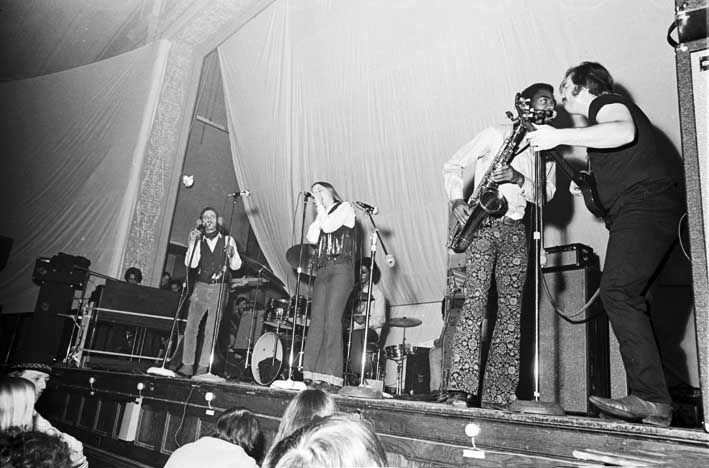
Mother Earth – Photo Copyright Mike Barich, St. Paul
PROCOL HARUM AND JOKERS WILD – February 23, 1969.
Original ad showed Fraternity of Man and Mother Earth.
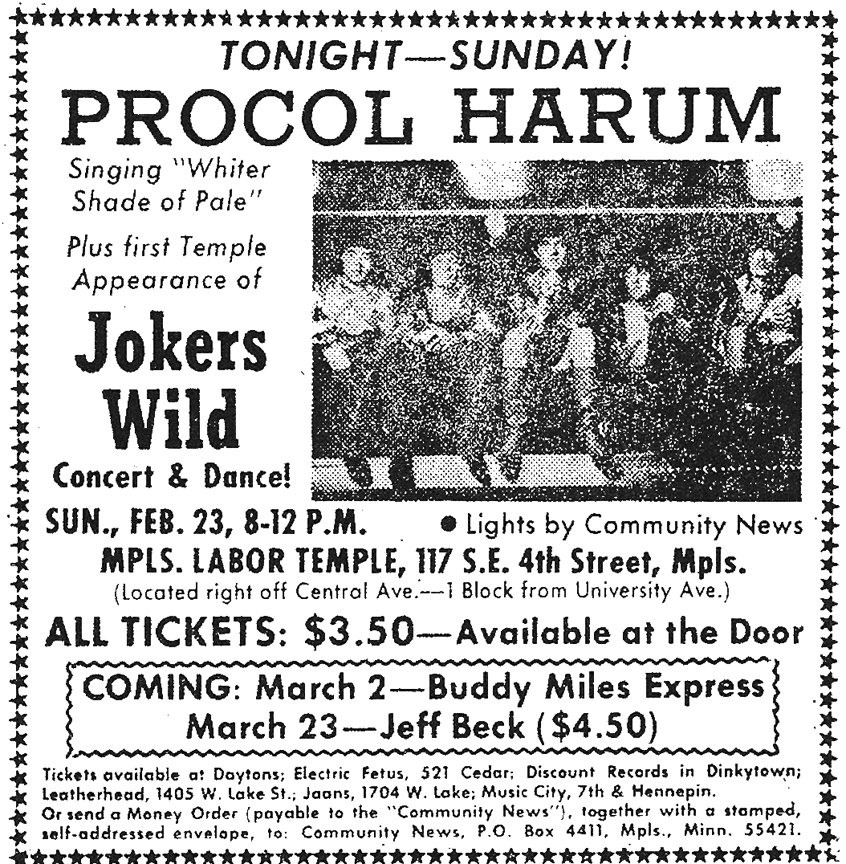
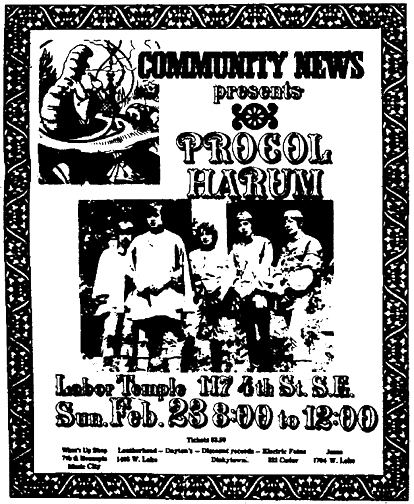
Minnesota Daily ad courtesy Robb Henry
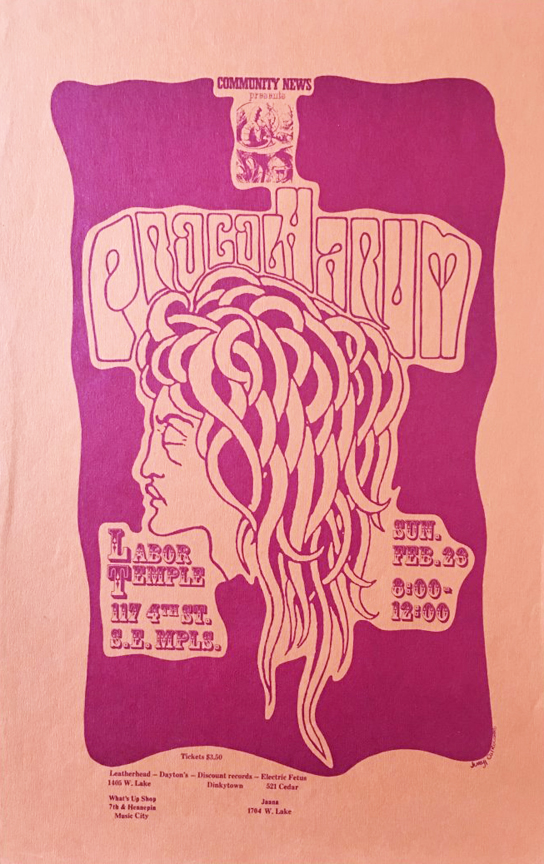
The show was opened by local group Jokers Wild, replacing the originally-scheduled Blackwood Apology. The photo below shows the JW in the crazy three-seat couch thing in the basement dressing room before the show. The photo was part of a spread in the Minneapolis Tribune about the Labor Temple on March 2, 1969.
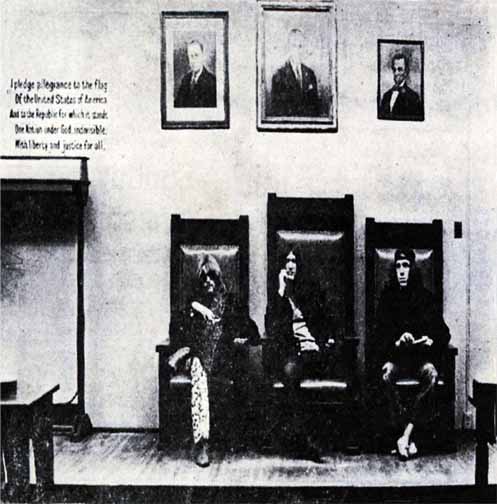
Photo by Mike Zerby, Minneapolis Tribune: Lonnie Knight, Denny Johnson, Pete Huber
The following photos of Jokers Wild opening the show are courtesy minniepaulmusic.com
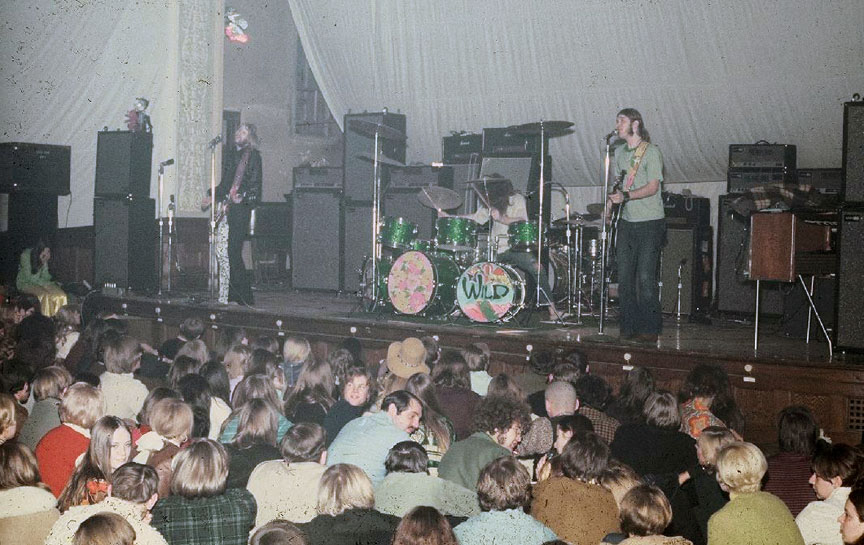
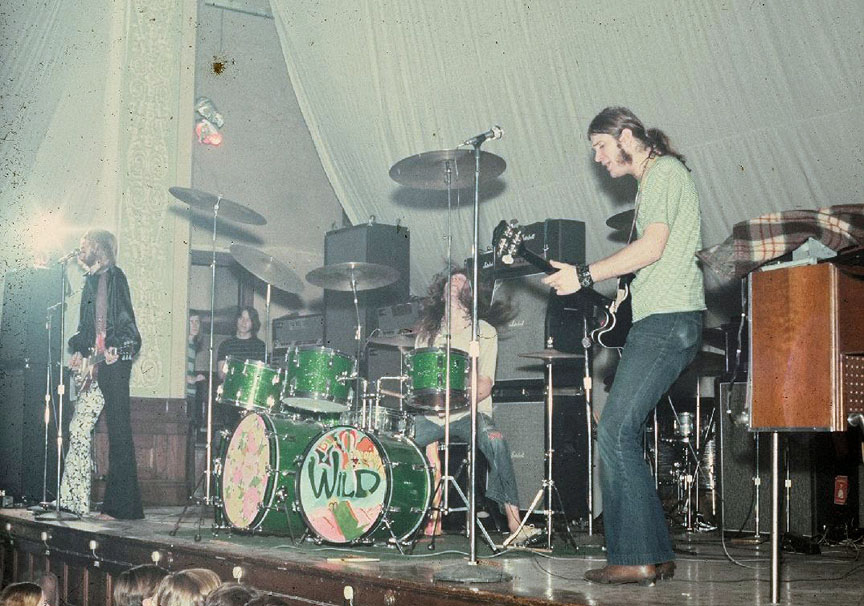
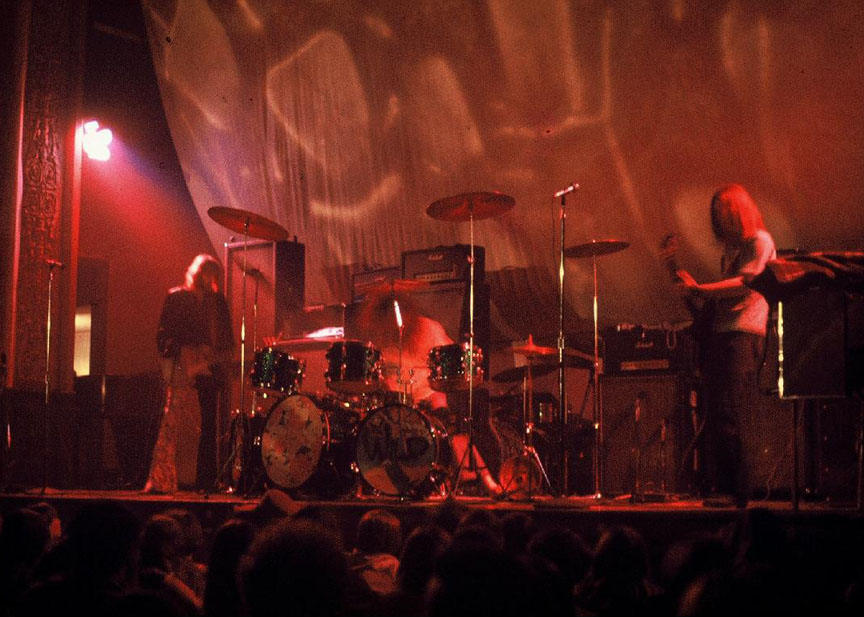
MINNEAPOLIS TRIBUNE, March 2, 1969
Entertainment columnist Allan Holbert reviewed this show and the Temple in general. Holbert seemed extraordinarily interested in all the hair – on the performers and on the listeners.
He was also very interested – or was he making fun of – the “weird costumes” – “see how the nonconformists conform..” He described:
- beads and bell bottoms
- the girl in the long lace dress and no underwear whatsoever. He even thoughtfully provided a photo of this young woman.
- the clever boy who had made himself a cape by splitting an old pair of pants
- Susie Cream Cheeses with their long, straight blonde hair and their big, flowered hats
- funny fur coats they found in grandmother’s attic
Holbert also described Community News’ light show, projected on three giant screens behind and to each side of the band:
weird, brightly colored images keep changing forms. Out of a big, purple, pulsating amoeba rides a cowboy from a black-and-white silent movie. An Andy Panda cartoon starts shaking and is, all of a sudden, a pink-and-orange geometric design. What look like big blobs of blood transform themselves into gaudy, green holes that could be pock marks on a face or craters on the moon.
He even described the air: “Instead of air there is a sweet-smelling, smoky smog caused by heat, sweat, incense and tobacco and maybe other leaves that burn.”
As for the music,
.. the Jokers Wild present some wild, crashing rock that will turn out, in the minds of most listeners, to be better than that to be presented later by the foreign group [Procol Harum].
Well, despite his obviously square, misogynist, and cynical viewpoints, Holbert does give us a window into the Wonderful World of the Labor Temple.
CONNIE’S INSIDER, March 1 – 8, 1969
Connie confessed that he was only there for a few minutes and regular reviewer Will Shapira couldn’t attend, so he couldn’t provide a regular review. Connie was backstage while the Jokers Wild were on, though, and he was impressed at the audience response. He also noted how hard the guys worked; drummer Pete Huber went through eight drum sticks just while he was listening!
Procol Harum’s sound seemed to echo classical works as well as jazz riffs and passages – Connie found the musicians to be outstanding.
BUDDY MIILES EXPRESS AND SOUTH 40 – March 2, 1969
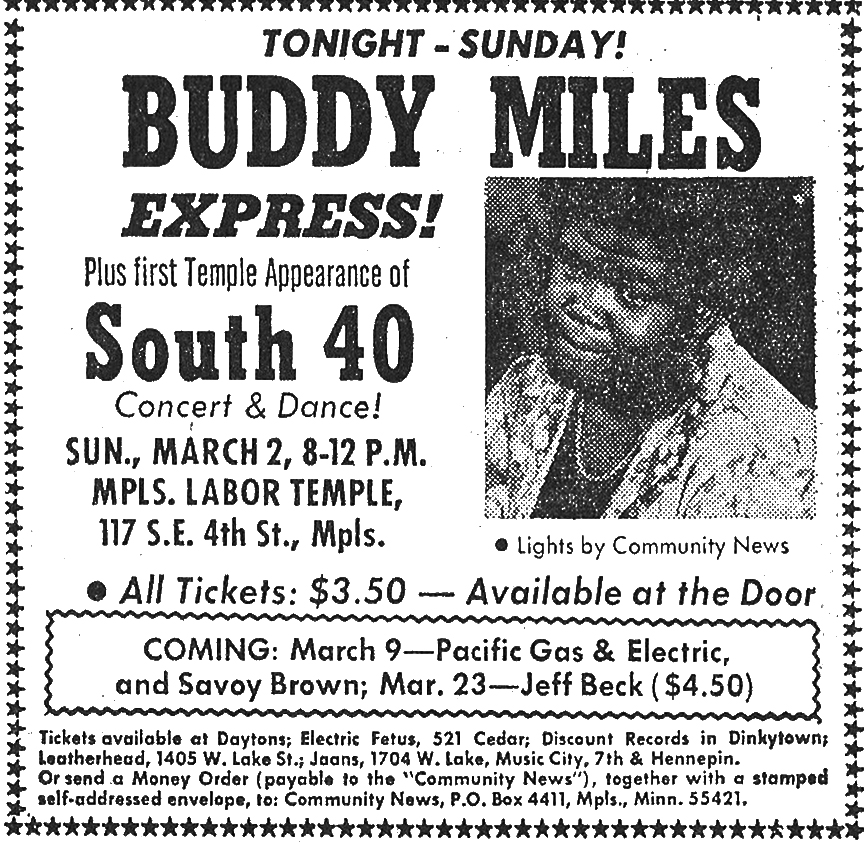
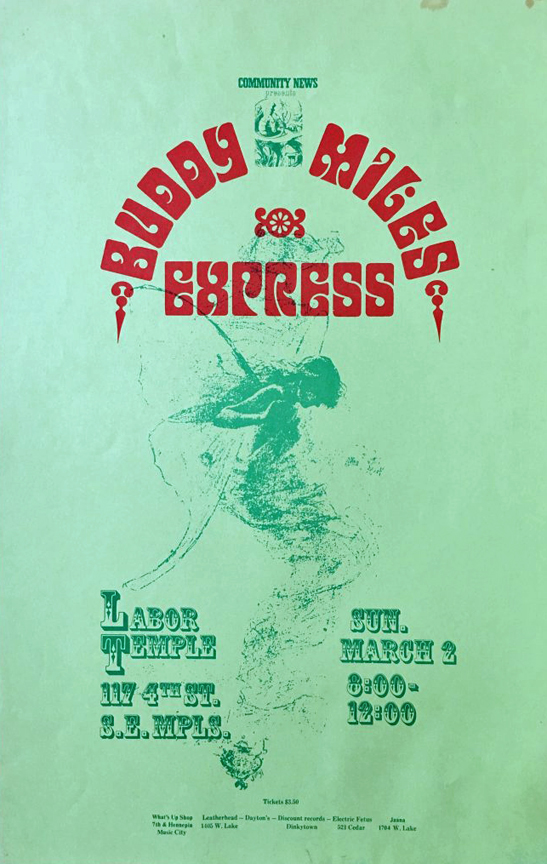
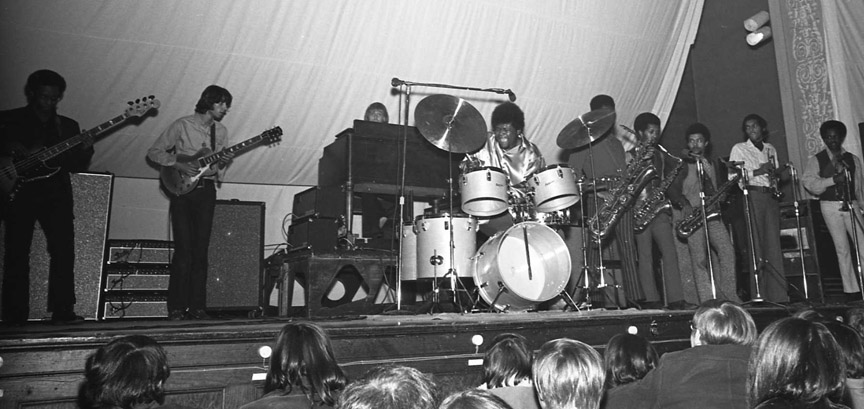
Buddy Miles Express – Photo Copyright Mike Barich, St. Paul
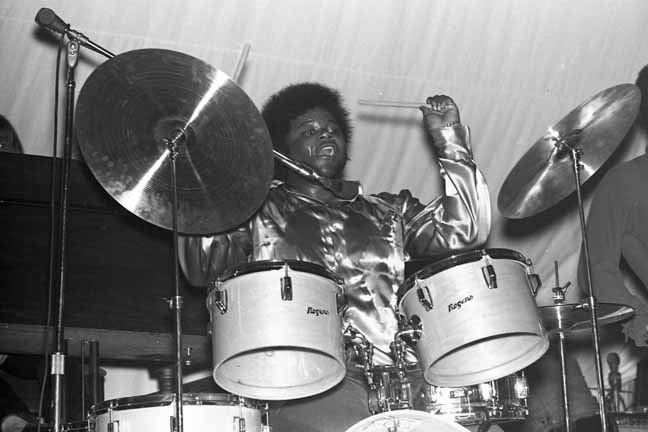
Photo of Buddy Miles copyright Mike Barich, St. Paul
CONNIE’S INSIDER, March 1 – 8, 1969
Connie admits again that neither he nor Will Shapira were able to see enough of the show to write a full review, and what he wrote may be based on what he heard. I will quote Connie’s remarks; note that his use of the word “colored” was undoubtedly not used as a perjorative, but an indication of Connie’s age. I’ll bet he caught hell for it, and he would go on to write extensively about black musicians.
Buddy is a true cannonball on drums, with one of the best op horn sections in the bussiness. This band plays blues-rock with a twist wich isn’t found in Blood, Sweat and Tears. It’s more colored blues oriiented than the Tears, who lean more towards jazz licks and musicianship. That might be because the horn section was all colored, bix. (sic)
Connie missed the South 40 completely, but heard from fans that they put on a good show. “They’re all good musicians, and they got Denny Craswell on drums, and he’s very good!”
PACIFIC GAS & ELECTRIC AND SAVOY BROWN – March 9, 1969
This was Savoy Brown’s first American tour and they would come back to the Cities many times. Local folk group Dawn opened the show.
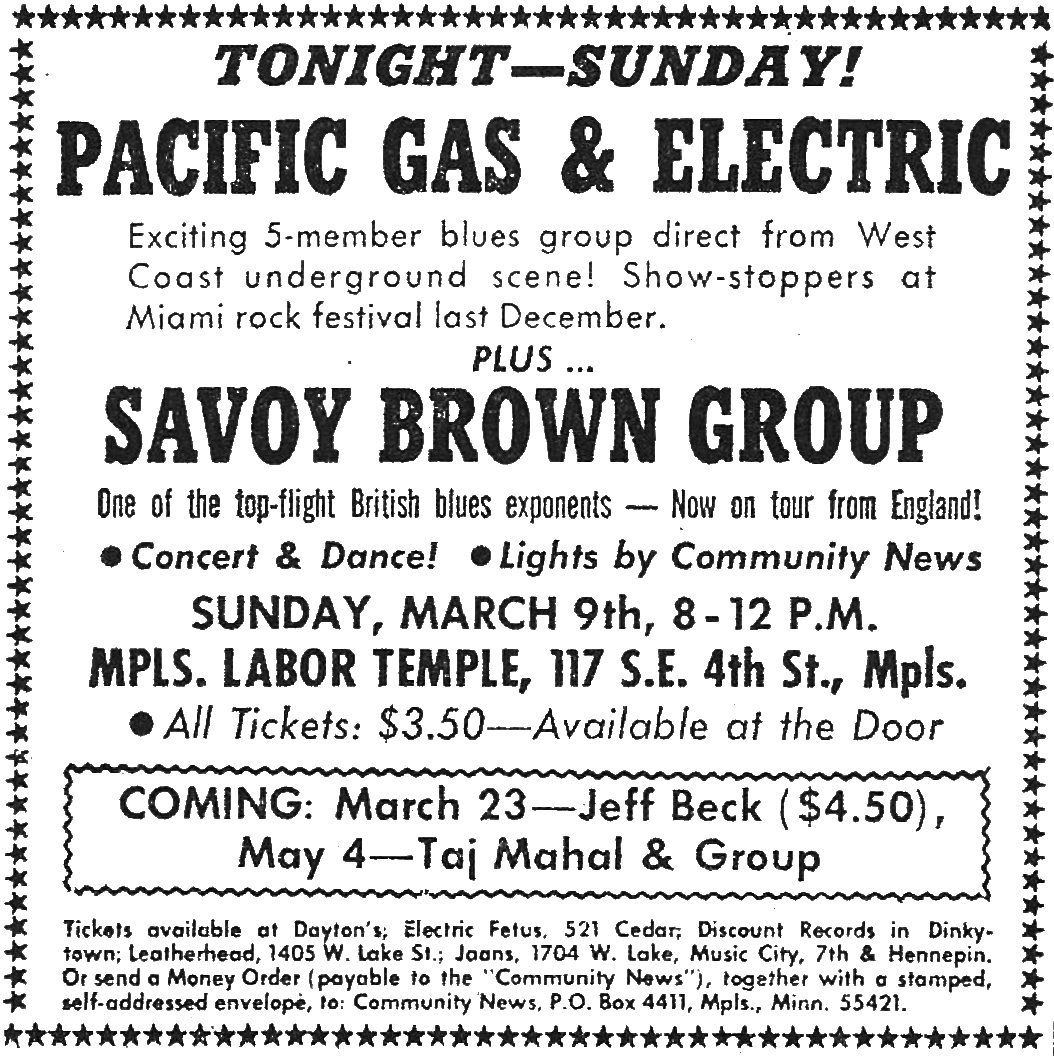
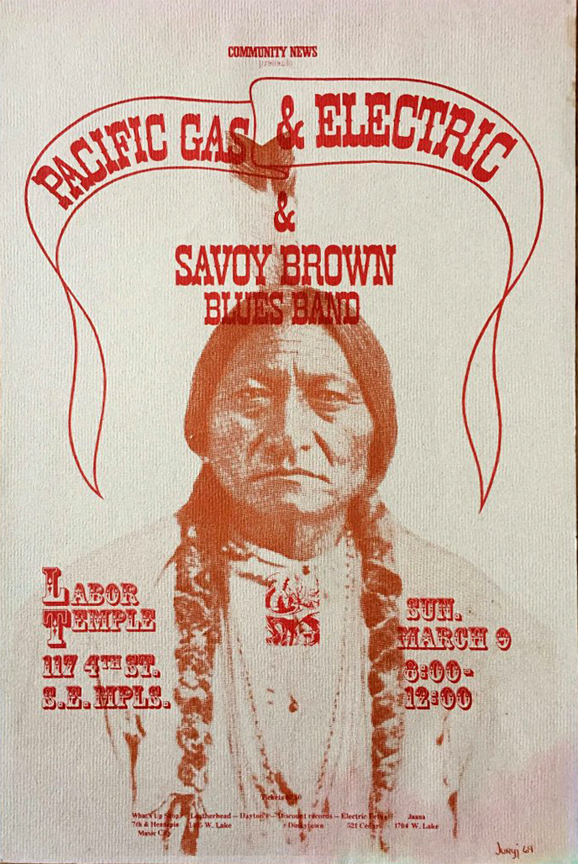
CONNIE’S INSIDER, March 22 – 29, 1969
Although no byline was given, this review was probably written by Will Shapira. It was was called the best double-bill yet, with both groups emphasizing a deep, gutty approach to the blues. Savoy Brown stressed instrumental solos, while PG&E’s lead singer “got to the highly enthusiastic audience with his soulful shouts and wails.”
This was Savoy Brown’s first American tour, and they “hauled out and resuscitated such forms as boogie-woogie and rock and roll.” They also presented a satirical montage of boogie and early rock, and the reviewer opined that “it would have been good to hear the group for an entire evening.
PG&E evoked some spirited dancing, hand clapping, and shouting, but didn’t reach the heights of Savoy Brown. Its guitarists did take several high-flying solos, though.
“The concert was another groove in what seems to be a never ending series of grooves.”
DAWN: This was a folk trio with Dean Carr, Joyce Everson and Ken Schaffer. Ken remembers:
Kim, the Lead Guitar Player for Savoy Brown, was quite taken by Joyce Everson and ended up taking her to England for Elton John’s people to help her out. They ended up producing an album for Joyce.
JEFF BECK GROUP, ZARATHUSTRA, SPIDER JOHN KOERNER, AND WILLIE MURPHY – March 23, 1969
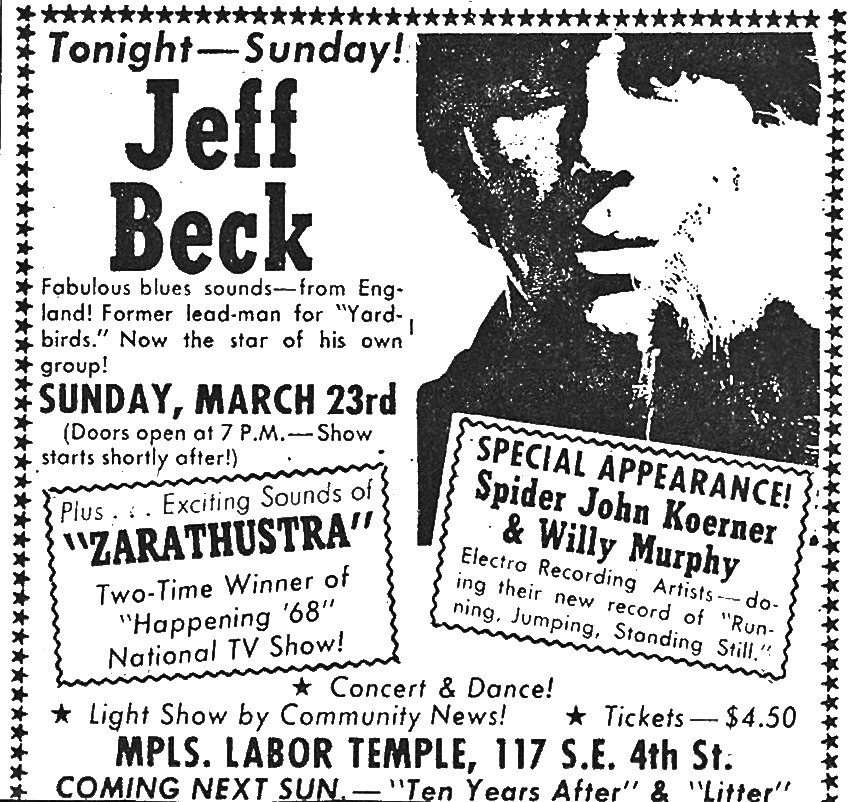
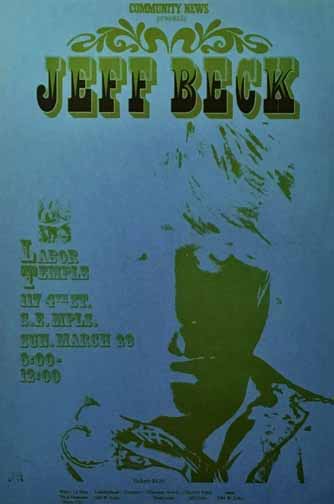
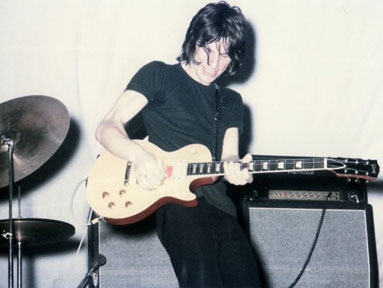
Jeff Beck photo by Jay Smiley via Robb Henry
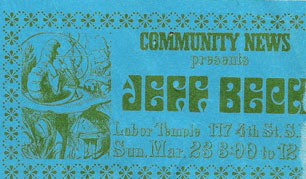
Ticket courtesy Steven Adams
At this point Rod Stewart was singing with Jeff Beck, and Steven Adams remembers that “when the sound system kept cutting out Stewart threw the mike stand through an amp and walked off the stage, never to return, despite a standing ovation.” Stewart left the group that July.
TEN YEARS AFTER AND THE LITTER – March 30, 1969
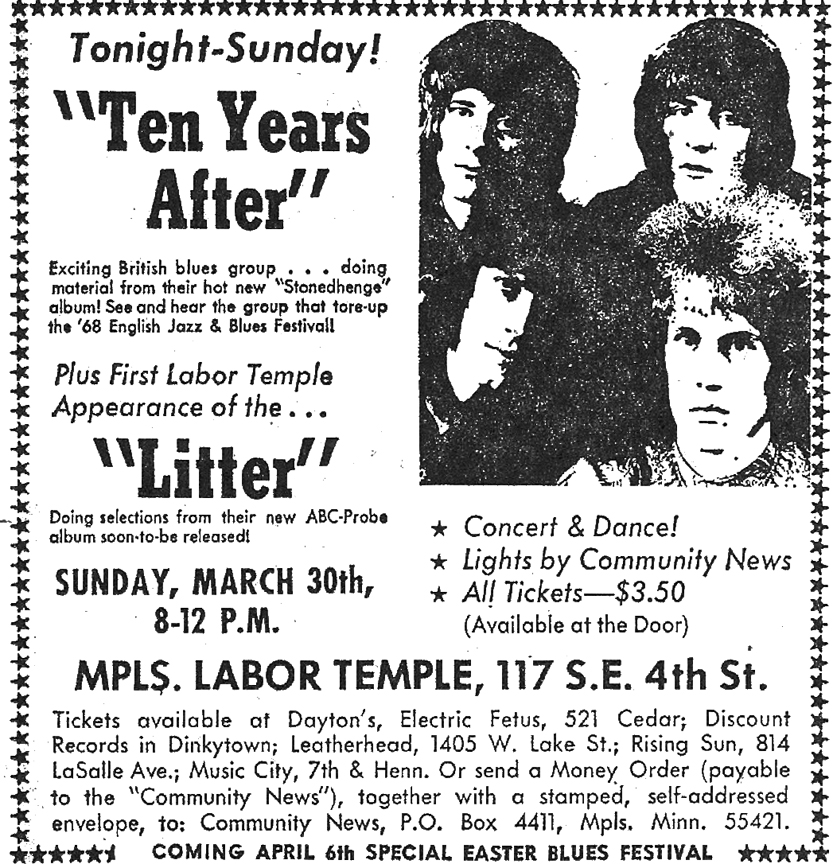
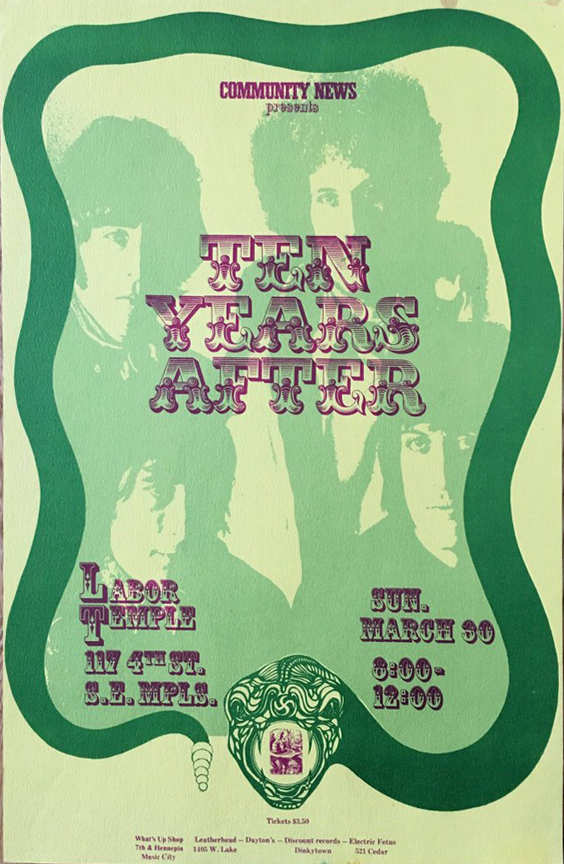
EASTER BLUES FESTIVAL – April 6, 1969
Advertised on posters, etc. were:
- Aorta
- Mojo Buford
- Stillroven
- Spider John Koerner
- Willie Murphy
A blurb in the Tribune on the day of the show also included:
- Tony Glover
- Dave Ray
- The Mill City Blues Band
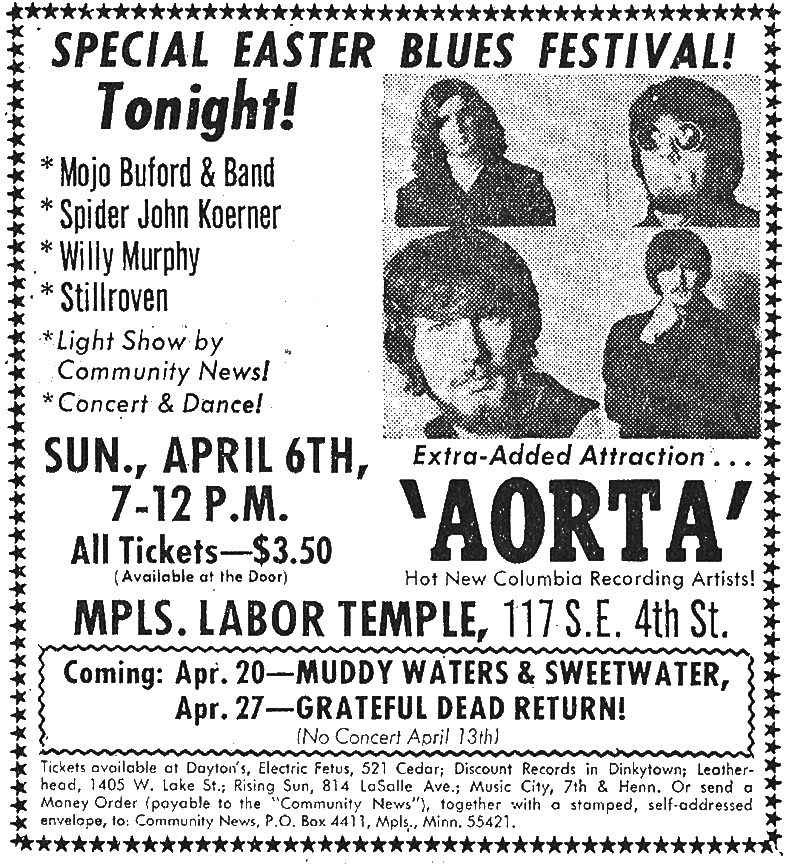
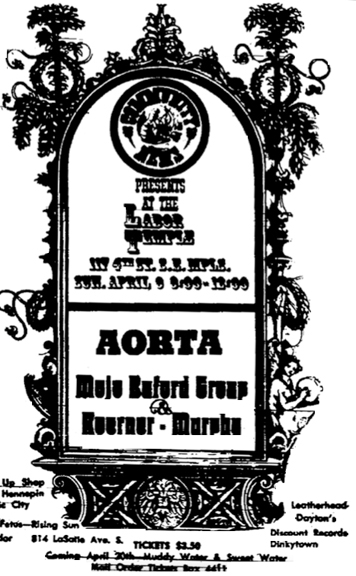
Minnesota Daily ad courtesy Robb Daily
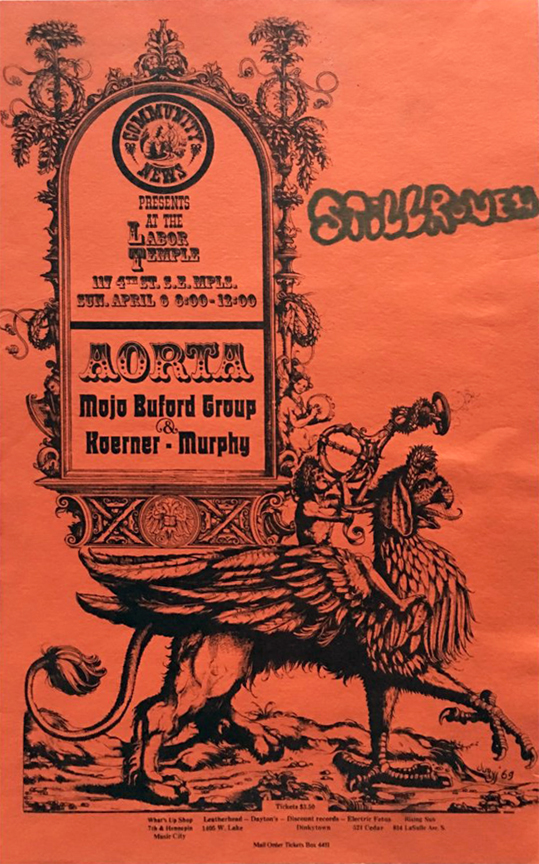
Image courtesy Paul Pash
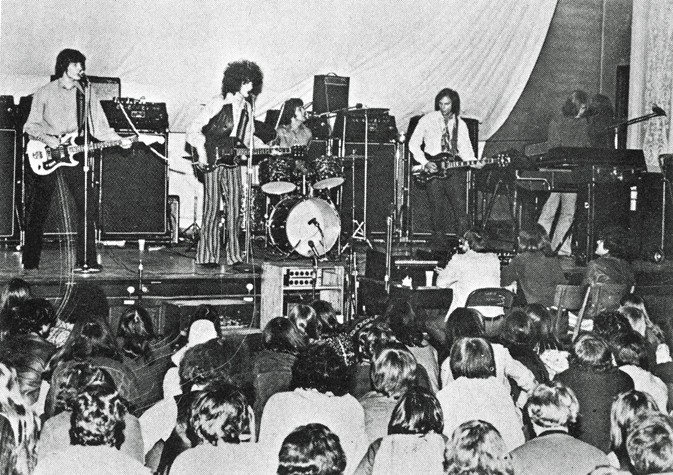
Stillroven – Photo Copyright Mike Barich, St. Paul
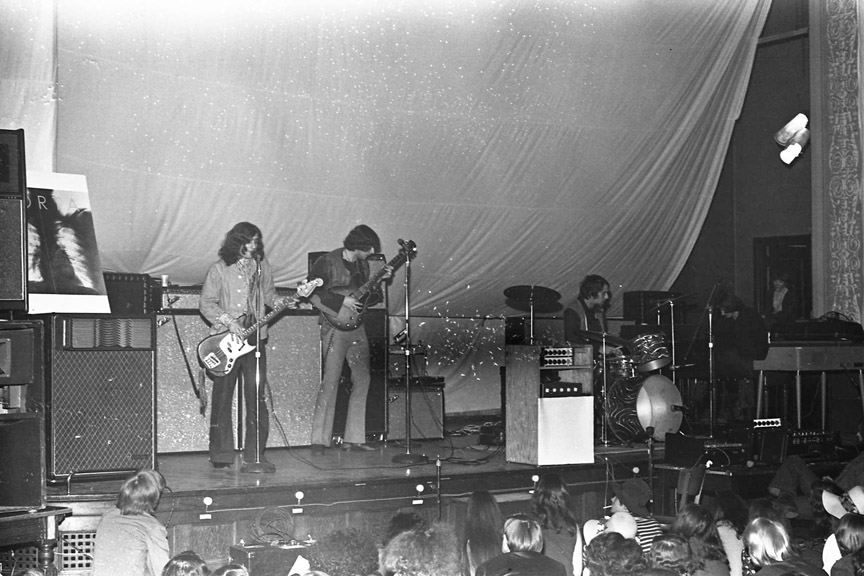
Aorta – photo copyright Mike Barich, St. Paul
CONNIE’S INSIDER, April 12 – 19, 1969
Spider John Koerner started the show with “a fine set of gutty vocals, many of which were augmented by some mellow lead guitar and piano solos.”
Mojo Buford was next, alternating with a second lead singer whose name was lost to time and space. They sang “some good, dirty bluess and both wailed nothing but blues on harmonica.”
“The Stillroven produced the smashingest sounds of the evening. Its vocal work was strong and there were several exciting guitar runs … The band sounds better than ever.”
Aorta was a national act with a set that was decidedly not the blues. But the audience dug it, “perhaps because the group was propelled by a slashing, really fine drummer and because its songs were well rehearsed if constructed of rather thin psychedelic material.”
An attempt to describe the two films that Community News showed was so convoluted that I’m too confused to try to translate. Something about Mickey Mouse and Carole Landis.
April 13, 1969: No Concert
MUDDY WATERS AND SWEETWATER – April 20, 1969
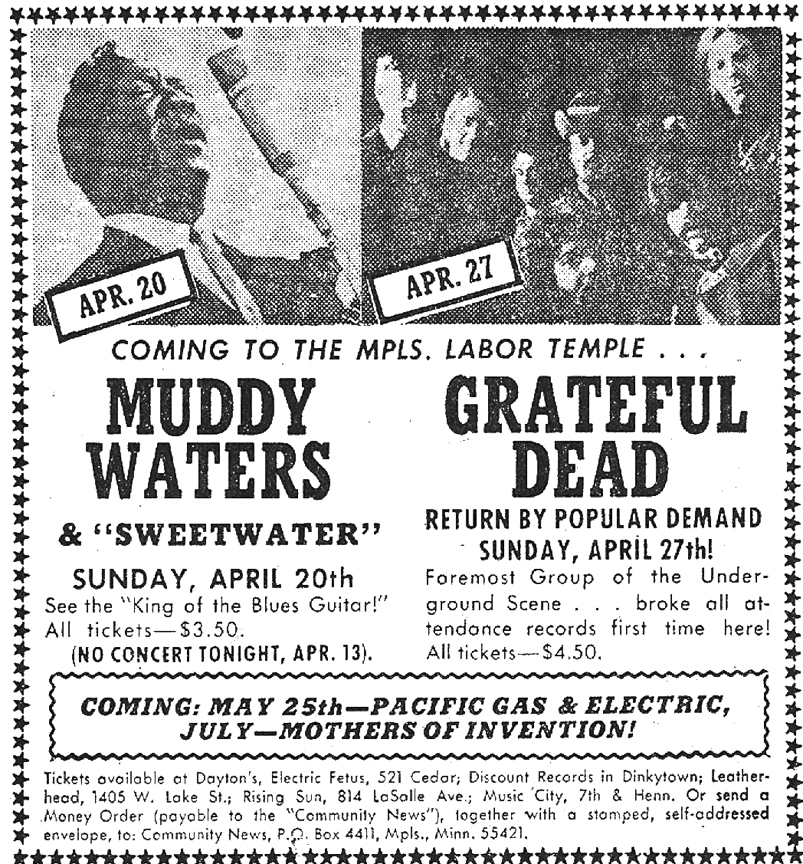
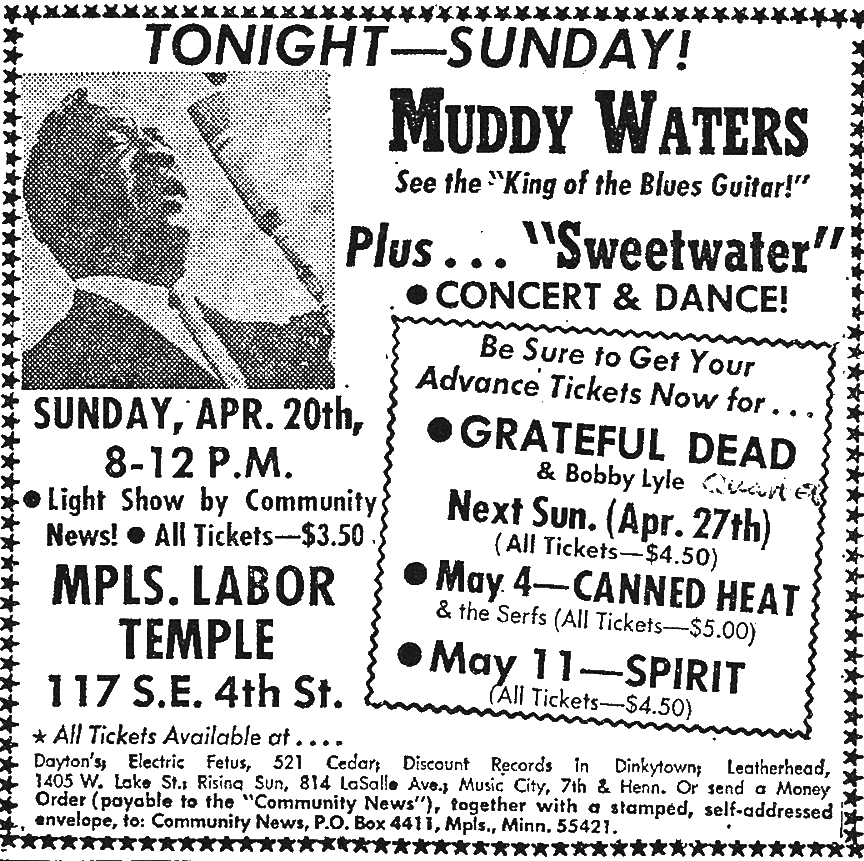
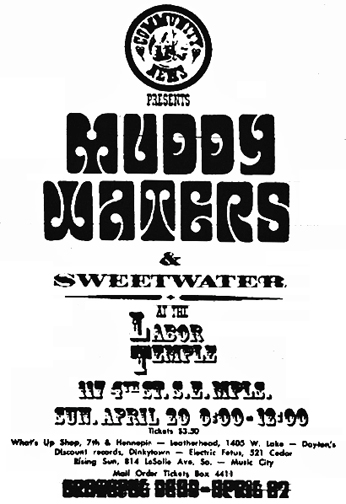
Minnesota Daily ad courtesy Robb Henry
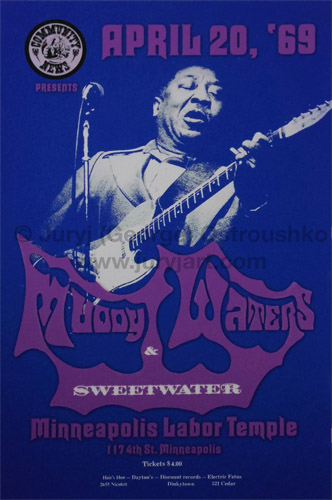
This is George’s 2018 reproduction of a poster that was never finished.
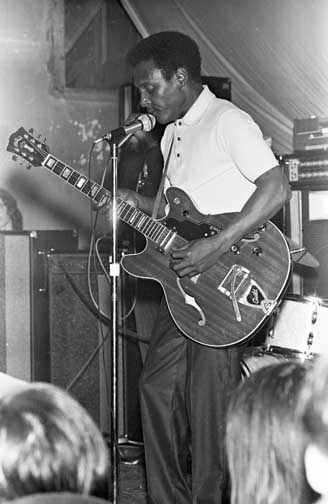
Muddy Waters – Photo Copyright Mike Barich, St. Paul
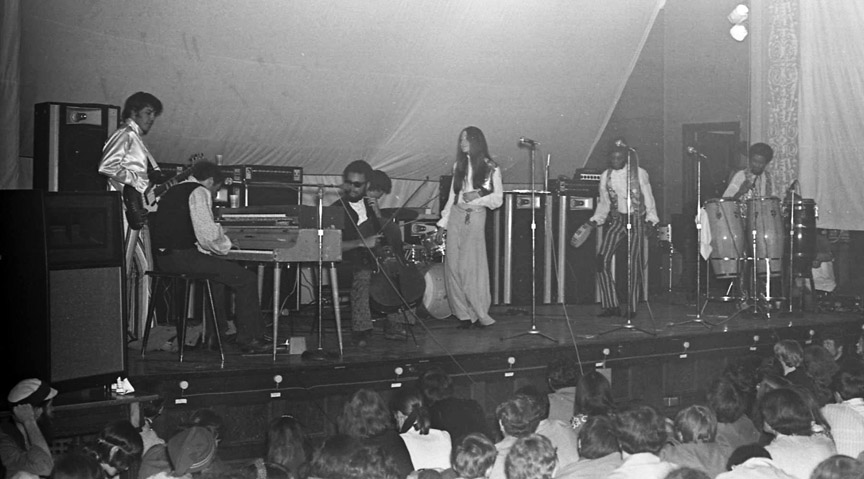
Sweetwater – Photo Copyright Mike Barich, St. Paul
MINNEAPOLIS STAR, April 22, 1969
Marshall Fine, then a U of M student, found the Muddy Waters/Sweetwater show “one of the best musical evenings the Twin Cities has seen in the last six months,” high praise indeed! Muddy Waters began with a short set, sticking to the blues instead of what Fine called the “psychedelic” band on his last album.
After a half hour break, Sweetwater “brought the audience to its feet and onto the stage with their exciting mixture of rock, classical and calypso music.” Muddy Waters came back for three more songs, including his signature “Hootchie-Kootichie Man,” and the crowd went home happy.
CONNIE’S INSIDER, April 26 – May 3, 1969
Muddy Waters appeared with a R&B sextet. His opening set included “Work Song” and “Hoochie Coochie Man,” and several “slow, funky original laments.”
Sweetwater’s conga drums provided an exciting beat, and an electric cello produced effects such as “the ear-piercing psychedelic,” “a jazz-like walking bass, and guitar-like picking.” Other instruments included a flute, electric piano, and vocal soloists. The high point was a half-hour song that featured an unnamed musician on the electric keyboard and harmonica. Dancing and stage rushing ensued.
At the second show, Muddy introduced his second guitar player as “Peewee” – “who also sang well.”
“In all, it was another exciting scene at the Temple and a return engagement for both groups would seem a must, judging by audience response on that warm and groovy night.”
GRATEFUL DEAD AND THE BOBBY LYLE QUINTET – April 27, 1969
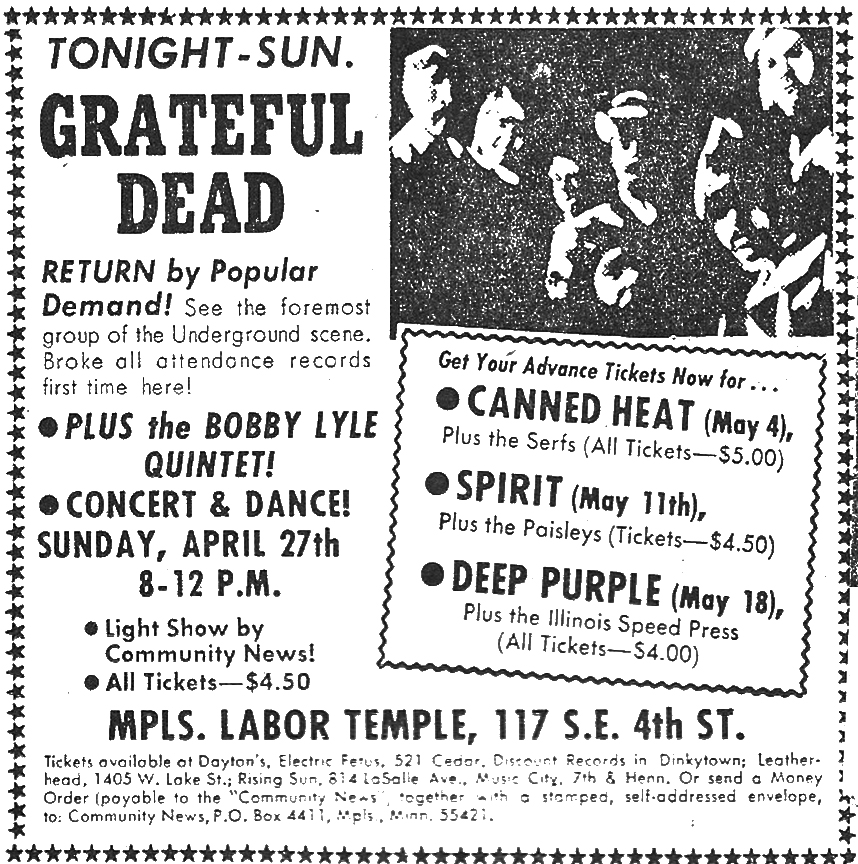
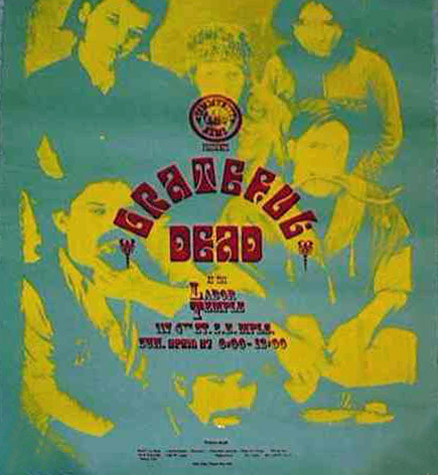
deadlists.com
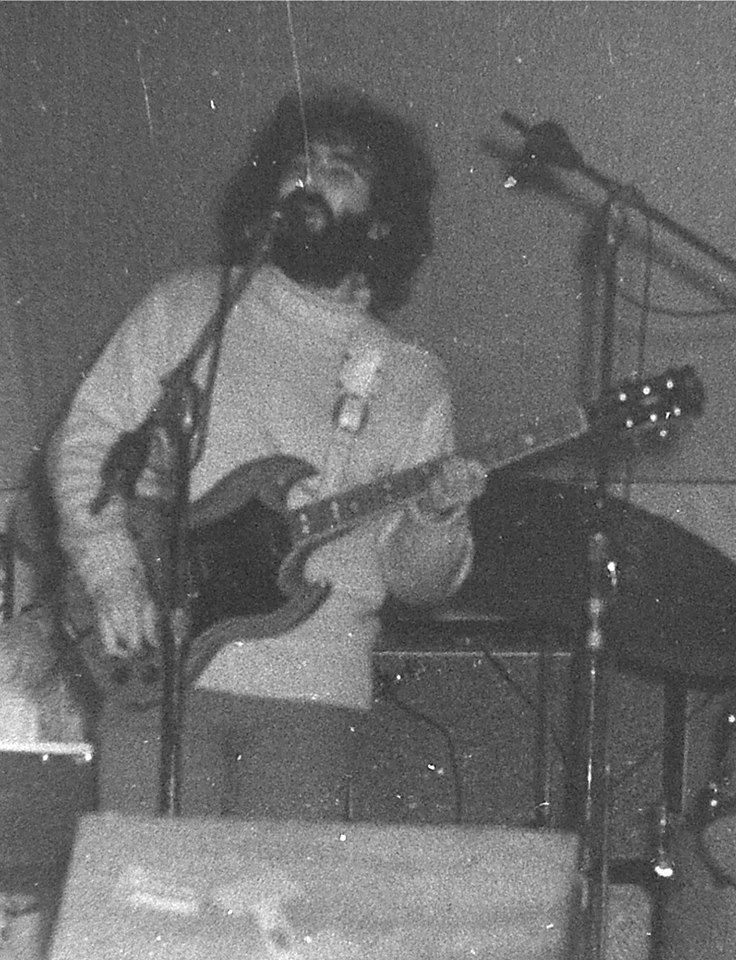
Photo by Gary Schwartz
MINNEAPOLIS STAR, April 28, 1969
It was a little difficult to tell whether Marshall Fine liked the Dead or not. “They have no distinctive style because they borrow from a number of types of music. Yet the sound, indistinctive as it may be, is their own. The Dead provided a pastiche of styles and a uniqueness of sound.” One song lasted an hour, beginning with “Turn on Your Love Love Light.”
Fine thought that the Bobby Lyle Quintet was out of place, “playing jazz that would have been appropropriate in a supper club,” but “a nice change of pace to the Temple crowd.”
CANNED HEAT AND THE SERFS – May 4, 1969
Taj Mahal was originally scheduled.
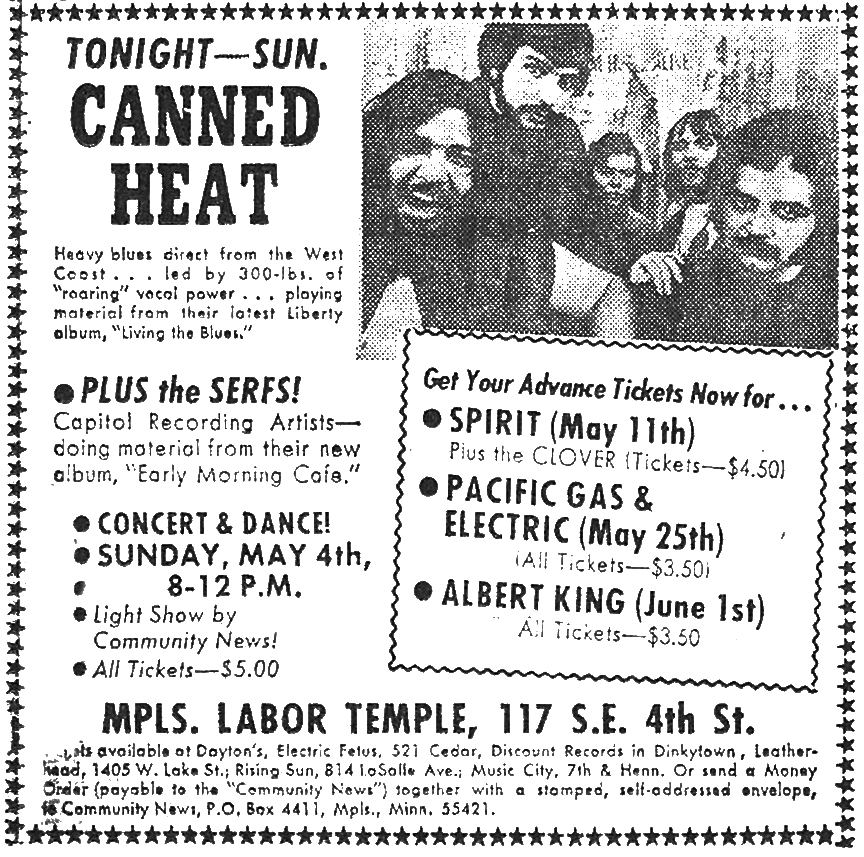
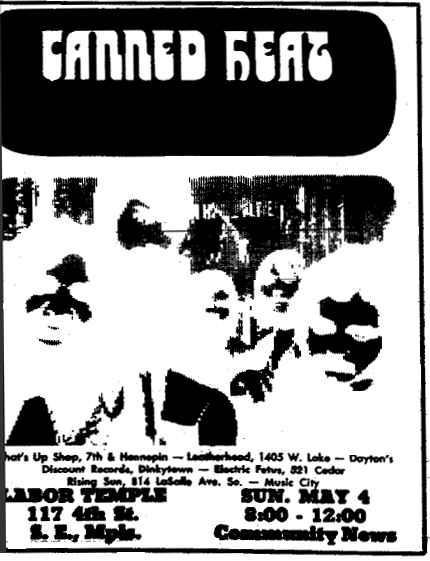
Minnesota Daily ad courtesy Robb Henry
The poster below of Canned Heat is not the original printing. George Ostroushko uncovered the original artwork tucked away in one of his portfolios. The poster for this show was actually an oversized silk screen poster and very few were ever printed, so very few if any survived. Georg reissued it using a different color scheme.
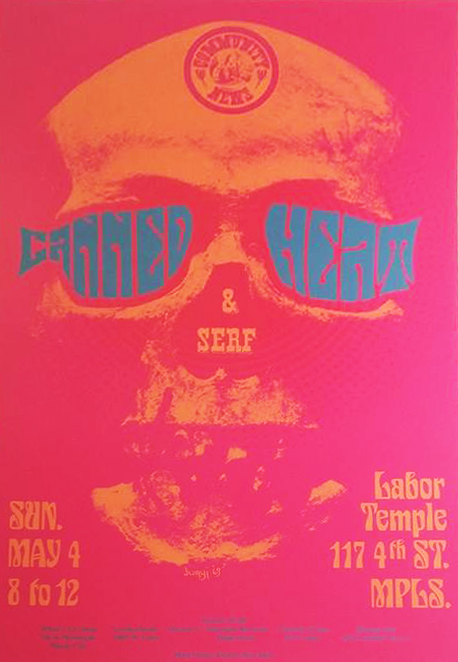
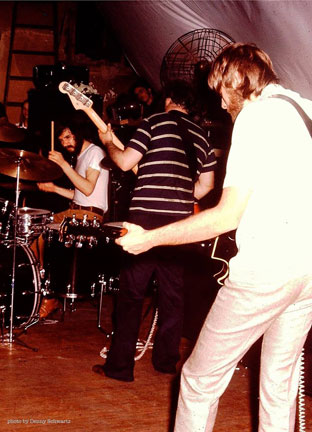
Photo by Gary Schwartz
Charlie Campbell remembers that when Canned Heat launched into “Boogie” the crowd formed a conga line that snaked outside the building and back in! Vernon remembers the police pulling the plug on the band at 12:30!
MINNEAPOLIS STAR, May 5, 1969
Marshall Fine commented on the “non-discriminatory” Labor Temple audience that cheered at anything. Canned Heat seemed to play more instrumentals than vocals: “They play all right but they don’t know when to stop. There is a line that divides good playing from wretched excess and they are continually crossing it.” The word “narcissism” was used.
The Serfs, from Wichita, were:
fast and tight and tight and knew when to call it quits with their instrumentally oriented numbers. They played a lively combination of rock, blues and jazz and showed the unique psychological know-how of leaving the audience seriously pleading for more. Canned Heat could take a lesson or two in that.
CONNIE’S INSIDER, May 17 – 24, 1969
Canned Heat was a gas until guitarist Henry Vestine lost himself in electronicsland during an extended set-closing performance of “Reef Ride Boogie.” Until then, the band had inspired the audience into a snake dance that twice wound its way from the main level up to the balcony with its sauna-like atmosphere. The group reachess tremendous emotional heights when belting out its patented blues-boogie things and why Vestine had to jump into that unmusical and ultimately boring electronics bag is a mystery.
The Serfs got an excellent review, playing as well or better than Canned Heat. The young jazz-rock band turned in a consistently “interesting and swinging set.” Most of the solos were taken by Freddy Smith on the tenor sax. Rick Margolis played the vibes with “cool, tense, lines.” Larry Faucette added several virtuoso solos on congas. The group was was called back for two encores.
IVORY TOWER
In the May 1969 issue of the Ivory Tower (a publication of the Minnesota Daily,) Tim Boxell wrote a piece on the local music scene, entitled “Rock is Alive in Minneapolis – But is it Well?” In it he discussed several venues, such as Someplace Else, Casino Royale, the New City Opera House, and Dania Hall. Most of his discussion was given over to the Labor Temple, however, and I will quote liberally.
Anthony offers a big-name rock show on a regular basis at $3.50 a shot, a light show, a wood floor to sit or daance on, and a place where the acoustics get the sound to you. The home of the area’s unions was converted to Minneapolis’ Care Package for the music-starved populace. Will it succeed?
So far Anthony and the Community News have managed to overcome difficulties which are by no means small. Plagued by capacity restrictions applied by the Fire Marshal after the initial planning and investment had been made, the lack of a real dressing room, a tiny stage, and a pervasive sense of the temporary, the place has nonetheless made headway. Limited capacity still remains the greatest problem and is truly a hindrance.
[The limited audience limits the amount Anthony can pay bands, and if bands want a percentage of the house, a small house is a disincentive to play.]
Anthony could go commercial and pack the place with boppers by booking Ohio Express, etc. Instead he maintains a definite standard in his choices, and has thus gained an appreciative following. In spite of costs, he has managed to bring in a pleasing variety of talent ranging from blues to acid and art rock. Proximity to Chicago has made Sunday evening in Minneapolis a desirable extra appearance for touring bands would be otherwise difficult to obtain. But the Temple could use a larger building if it hopes to attract the expensive artists.
How long will it last? Avalon ballroom and Kaleidoscope folded on the West Coast for reassons that could apply here. The Byrds, Glenn Campbell, and even the Beatles now are making a transition to the country western sound. Will the market for rock survive? Finally, can rock escape the repressive Establishment powers working against it, plus the indictment that its sound is a cause of early deafness and accompanying strobe lights are seriously damaging to sight?
Dance places, of course, will survive regardless of changes in music. And theatrical productions using rock music, such as the “House of Leather,” might be a successful and lasting development. But unless a better location for the Labor Temple audience can be found, the future for serious listeners looks doubtful.
SPIRIT AND CLOVER – May 11, 1969
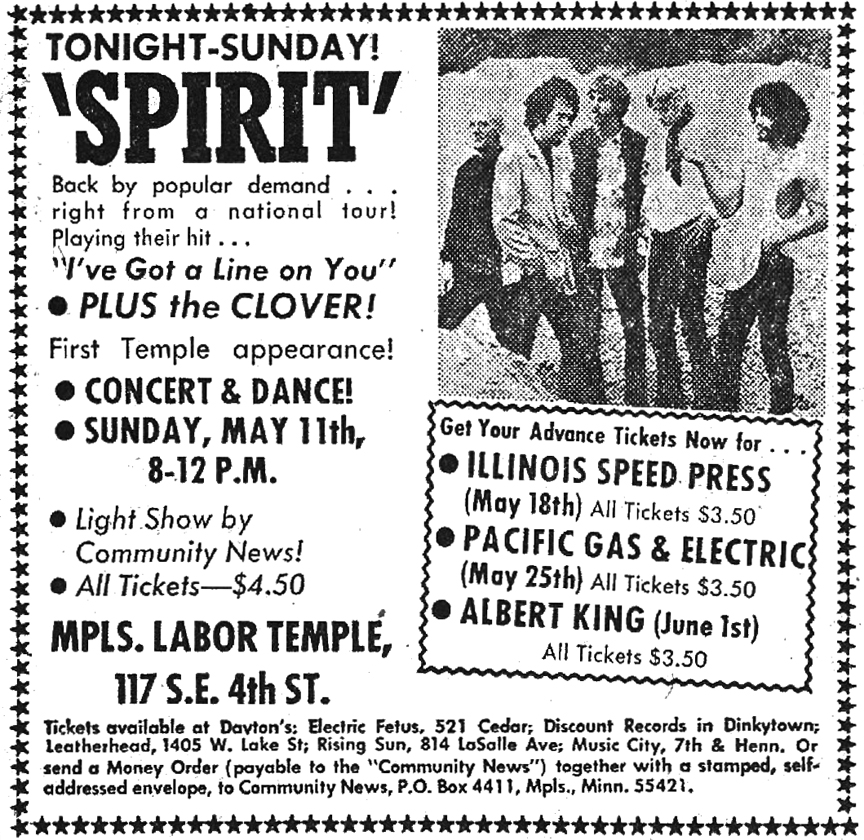
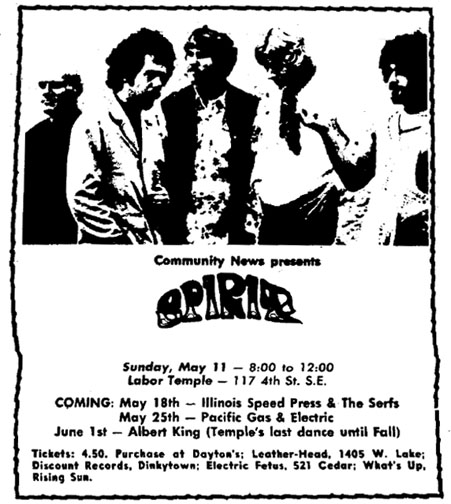
Minnesota Daily ad courtesy Robb Henry
MINNEAPOLIS STAR, May 13, 1969
Marshall Fine described Spirit’s sound as refreshing – “like a pitcher of iced water on a hot day.” John Locke’s electric piano was “chime-like,” a perfect counterpoint to Randy California’s lead guitar. California sometimes “indulged in little amplifier concertos irrelevant to the song.” Fine’s only complaint was that the volume on the bass and the microphones was so high that the sound was muddy.
KEVIN ODEGARD
Kevin compared this show to Spirit’s February 16, 1969 show:
Seven months after their first appearance, Spirit returned to the Labor Temple with a back line and PA provided and sponsored by Sunn Amplifiers of Portland; specifically a new solid state model not driven by tubes like the Sunns used by The Who. Absent the funky Fender reverb and punch, this set was a mushy, nondescript, cardboard disaster start to finish, as if the band had sold their souls to the devil at the Crossroads.
DEEP PURPLE AND THE SERFS – May 18, 1969
Illinois Speed Press was originally scheduled. There is a poster with that lineup, but I don’t have it.
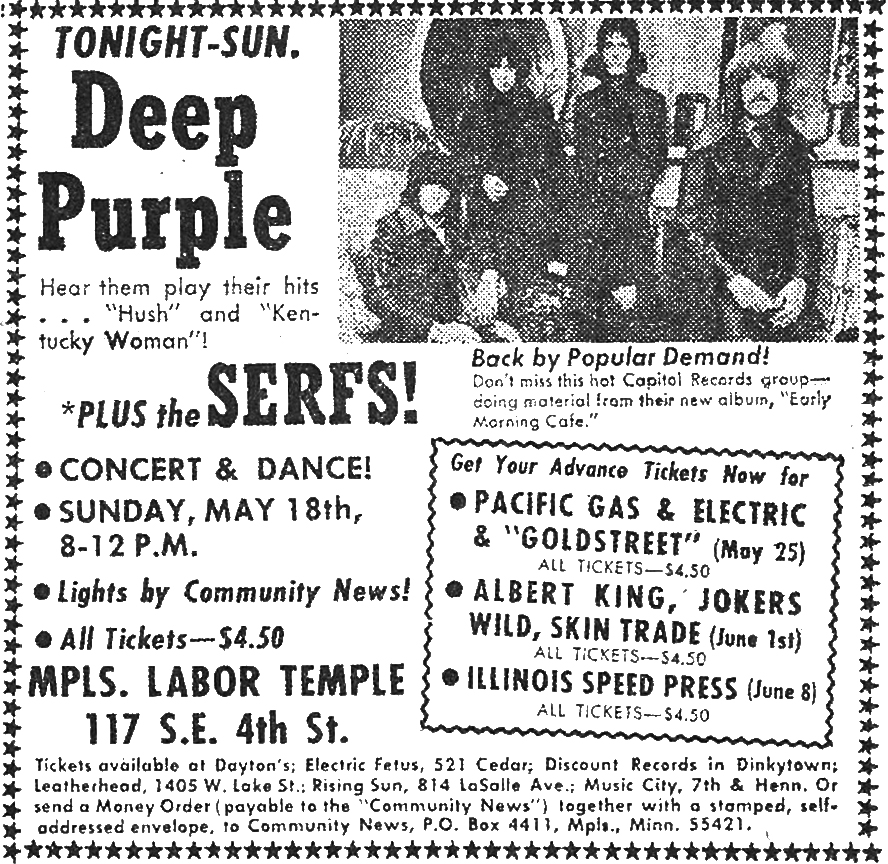
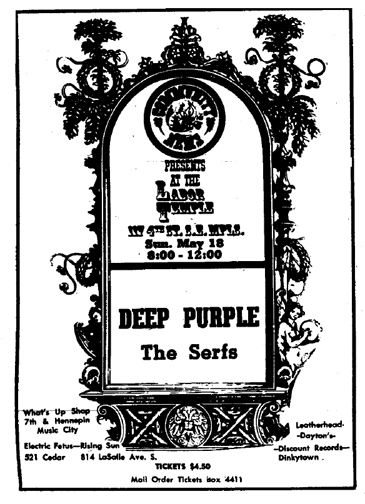
Minnesota Daily ad courtesy Robb Henry
The original poster for the show has been lost, but George Ostroushko, who drew the artwork, has shared the master from which a three-color silkscreen was made.
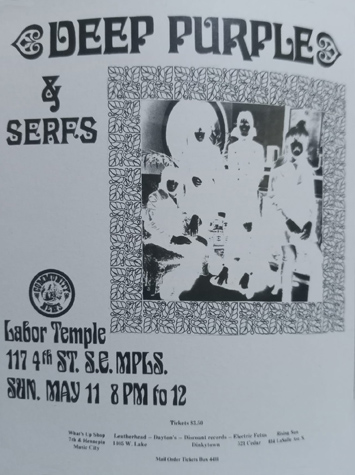
Courtesy George Ostroushko
PACIFIC GAS & ELECTRIC AND GOLDSTREET – May 25, 1969
Some ads identified the warmup band as Tradewinds. Tradewinds changed its name to Goldstreet in May 1969. Members of Pepper Fog would later take the Goldstreet name in the early 1970s.
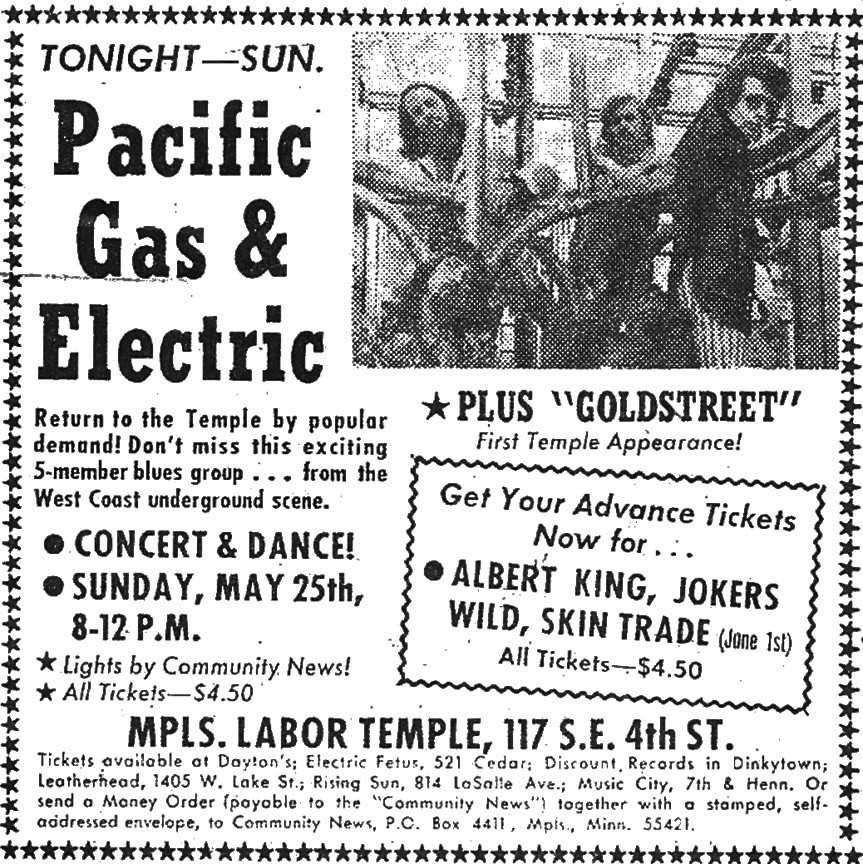
ALBERT KING, JOKERS WILD, AND SKIN TRADE – June 1, 1969
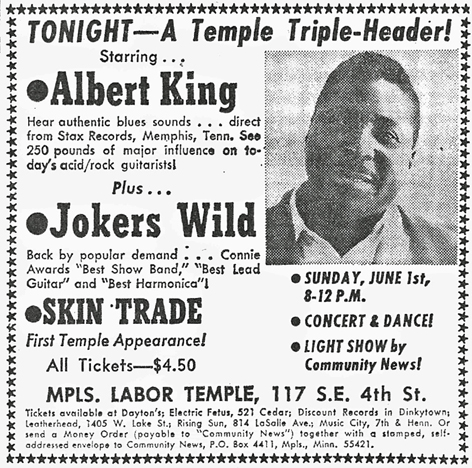
MINNEAPOLIS STAR, June 2, 1969
Marshall Fine described what really happened. Locals bands Skin Trade did 45 minute set, Jokers Wild played for an hour, and Scott Bartell, who was identified as the public relations director for Community News, told the crowd that Albert King was not coming. No refunds were offered, but tickets could be used the next time King appeared. This did not go over well for the 1,000 people who would have not otherwise spent $4.50 to see two local bands, good as they were; Fine reported that Bartell was greeted with “jeers, catcalls and a stream of shouted obscenities.”
EXIT CHARLIE CAMPBELL
There were no more shows in the near future: those planned for Illinois Speed Press (June 8), Paul Butterfield, and the Mothers of Invention never materialized. On July 5, 1969, it was announced that the Labor Temple “has closed for the summer.” Campbell felt that Community News got unjustly blamed for the Albert King fiasco and ended his relationship with David Anthony and the Labor Temple.
SKIN TRADE, C.A. QUINTET, AND UNDERGROUND SOUNDS – July 20, 1969
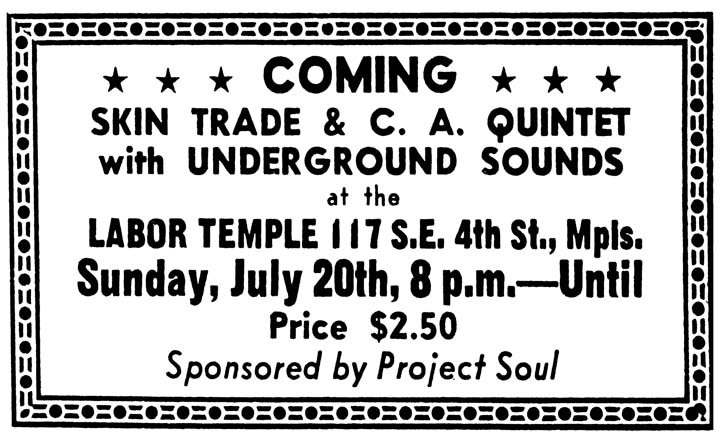
When Mike Barich sent me Ken Erwin’s itinerary of the C.A. Quintet for part of 1969 that included a show at the Labor Temple in July, I was … surprised. Ken didn’t remember much about the gig except for something very important: it was the night Neil Armstrong first stepped on the moon! Here’s what Ken did remember:
I looked it up and the moment happened right at about 10 pm. Psychedelic!
A NEW SEASON
David Anthony began a new season on his own at the Labor Temple in September 1969, with a new light company, Center of Consciousness. He said in an interview that he would have liked to run all summer, but without air conditioning it was impossible. He also mentioned other events such as showing films; “Yellow Submarine” was an example. (Minneapolis Star, September 19, 1969)
SEASON OPENER WITH FOUR LOCAL BANDS – September 14, 1969
- Thundertree
- Stone Blues
- Pepper Fog
- The Marauders
Unlike all of the others, the poster below was NOT the work of Juryj (“George”) Ostroushko.
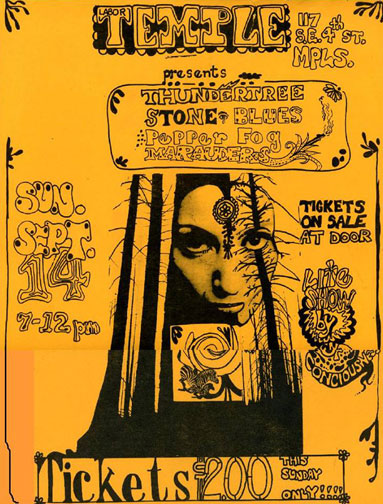
Poster courtesy David Mueller
MC5 AND COTTONWOOD – September 21, 1969
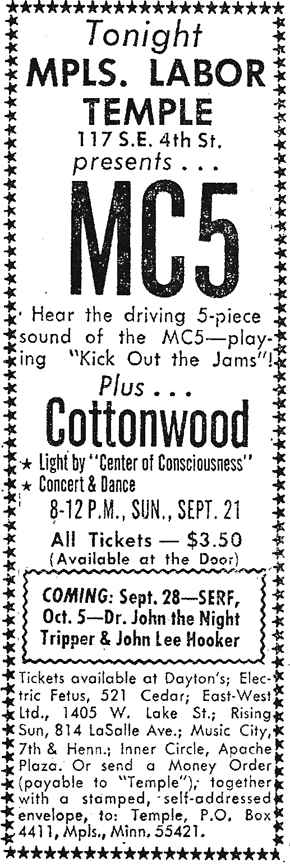
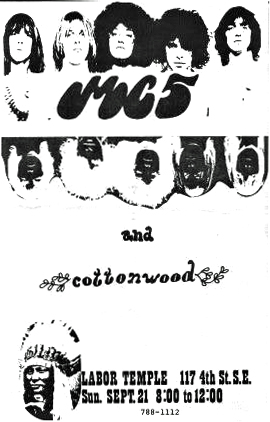
Handbill courtesy Ron Domilici
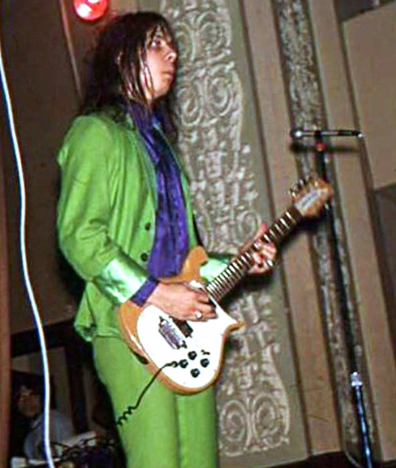
Fred Sonic Smith of the MC5 at the Labor Temple. Source of photo unknown.
MINNEAPOLIS STAR, September 22, 1969
Well, Marshall Fine did not dig the MC5. “Loud, Louder, Loudest,” was the header. The headline was “Rock group was so bad it was funny.” Yipes! He likened it to the old “Batman” series, where something was “so terrifically bad that the only possible reaction to it was fits of laughter.”
Many good lines in this review:
Any semblance of music was lost. You couldn’t hear, so much as feel, the bass and drums. Occasionally you could catch the shriek of a wounded guitar but usually it was squealing so high that dogs in the vicinity of the Temple barked.
Adding to the humor of a very bad band were the occasional dance steps that the whole band (except the drummer) would break into. They looked like wild-haired escapees from the Rockettes.
They played songs like “Rocket Reducer No. 62 (Rama Lama Fa Fa Fa),” “The Human Being Lawnmower (Chop Chop Chop)” and “Teenage Love,” but these were distinguishable from each other only by the titles. They finally ended with their “hit” (?), “Kick Out the Jams,” a repeat of every song played in the preceding 45 minutes. But apparently by that time, those in the crowd were laughing so hard that they called the group back for an encore. And what do you think they played? Why, “Louie, Louie,” the rock song that ever beginning rock guitarist learns before he’s 13.
That cracked the place up totally. I’m not sure whether those in the audience were laughing or deaf but they actually stood up and cheered.
Fine ended with a suggestion that future audiences be warned with a poster that read “In Person = The MC5! Laugh Riot of the Century!”
MINNESOTA DAILY (date unknown)
Thomas Utne’s review was as much a rebuttal of Fine’s review in the Star as his own review of the show. He said that the MC5 “raised the audience to its feet screaming in exaltation,” a reaction that Fine did not understand. He called them “a relief from the ever-increasing sophistication that rock has been undergoing the past few years..”
Some other quotes from his review (he never mentioned Fine by name):
TheMC5 has found something to wake up those base emotions of ours we’ve been hibernating since Elvis became an actor and the Beatles stopped being Early Beatles.
Mike Davis on bass, Dennis Thompson on drums, “Sonic” Smith and Wayne Kramer on guitar all amplify the image of the golden era of rock because they all look like juvenile delinquents.
The Labor Temple crowd seemed all too aware of their growing reputation for over-responsiveness and stayed cool for the first couple of songs but they did catch on soon enough … They were all ready, that is, except for the Star reporter, who preferred laughing at the MC5 to laughing with them.
CONNIE’S INSIDER, October 18 – 25, 1969
The Insider didn’t really review this show except to compare it to the Serf show the week later, and not in a good way.
Sometimes, you really wonder why people go to rock concerts. I mean, for MC 5, the Labor Temple was filled, yet it was really little more than an excruciatingly loud big beat with almost nothing else to sustain it.
SERF AND TRIAD – September 28, 1969
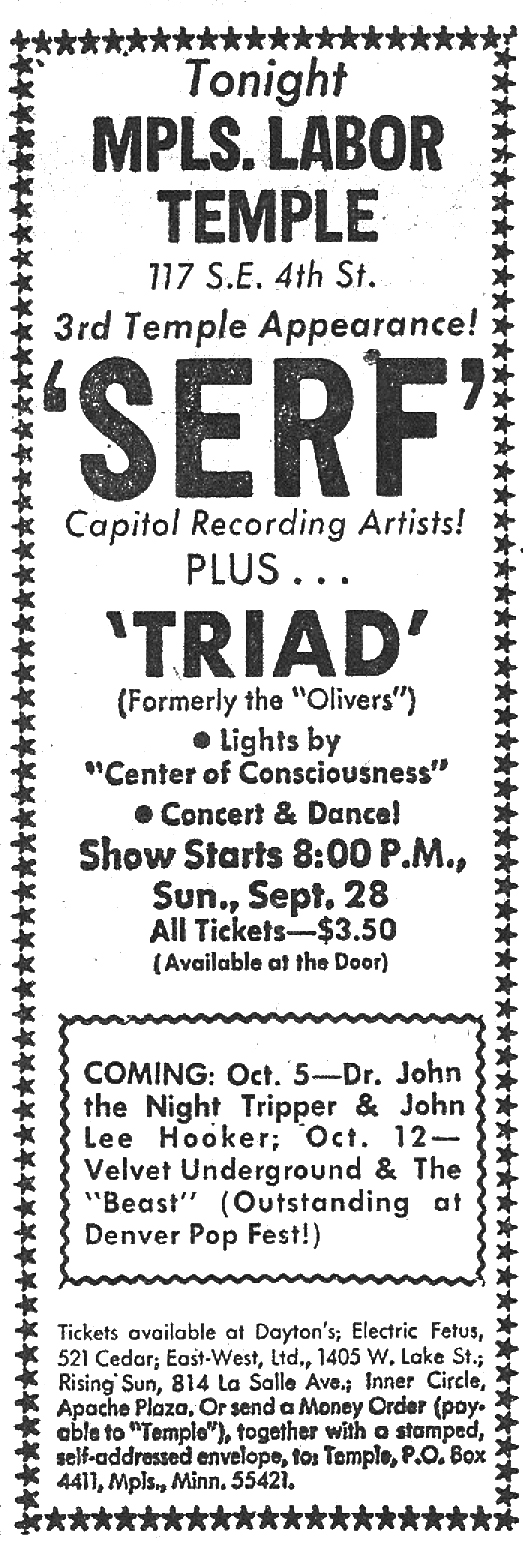
MINNEAPOLIS STAR, September 29, 1969
Marshall Fine reported that Serf played to only a couple hundred people. They were supposed to be the opening act for the Charlie Musselwhite Blues Band, but when that fell through they moved up to the main act, which they weren’t used to. They had been great opening for Canned Heat earlier in the year and got a good review, “but as a featured group, they don’t make it. They have no special charm, no charisma, to hold the audience”s attention. They’re okay to listen to for a while but they soon get boring.”
CONNIE’S INSIDER, October 18 – 25, 1969
The Insider complained that Serf was a superior band to the MC 5, but only a couple of hundred people showed up. “A great many people missed a truly beautiful concert by this well-trained, disciplined, yet always alive and swinging band from Witchita… The group blew its guts out right along, even though it could see how sparse the audience was.”
DR. JOHN AND JOHN LEE HOOKER – October 5, 1969
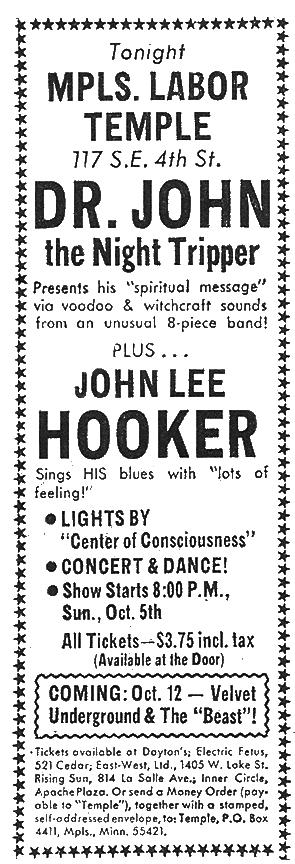
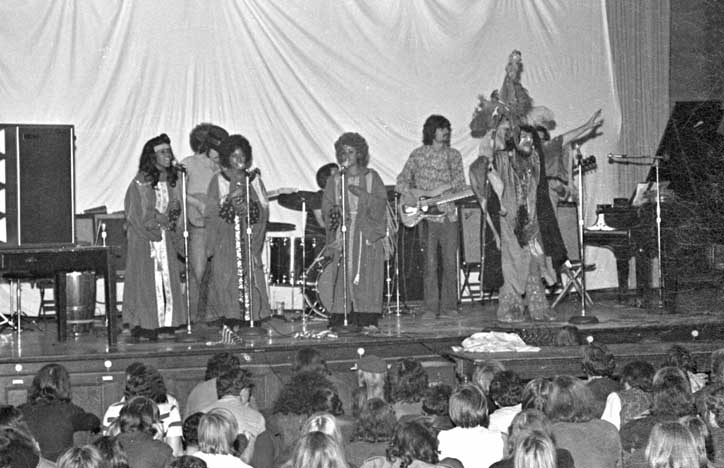
Dr. John – Photo Copyright Mike Barich
MINNEAPOLIS STAR, October 5, 1969
Marshall Fine reported that when nobody heard from John Lee Hooker, who was due to go on at 8, Dr. John went on and played for 2 1/2 hours. Fine said that the Night Tripper won over the audience that had come to see Hooker.
He comes on initially like the Crazy World of Arthur Brown, in a costume of wings and feathers, but where Brown is all show, Dr. John is all guts.” He was backed by a female trio, and the rock group was “average.”
This music was earthy rhythm and blues but lacked tightness. Songs ended seemingly on a whim, and never in the logical places. They never built to a crescendo but just left you stranded, holding the pieces of an unfinished song.
MINNESOTA DAILY, October 10, 1969
Thomas Utne’s review described Dr. John coming out as a sort of devilish persona, but unable to carry it off because he was “too chubby and too repugnant to effectively carry the Satanic mood” as Arthur Brown or Jim Morrison could have.
That’s not to say his entrance wasn’t interesting though. He comes on as wildly as Arthur Brown, if not with Brown’s class, wearing floor length robes, ornate medallions, an eagle with wings spread, perched on his crown, and a scepter with a dead chicken hanging from it. His shoes look like bunny boots with fur.
CONNIE’S INSIDER, October 18 – 25, 1969
This sounds like Connie himself:
Dr. John comes on wearing wild voodoo horns and plumed hats. He growls, plays guitar and piano, and presides over an ensemble that includes three girls singers, three guitarists (the lead did some nice things) and jazz and Afro-American percussion.
His sound is unique and often stirring. In some wayss, he is remindful of some voodoo things Perez Prado and Shorty Rogers did a decade ago, the exciting “Voodoo Suite” in particular. In all, Dr. John gave an entertaining performance and should be thanks for bailing the Anthony organization out of a sticky situation.
DAVID ANTHONY BUSTED!
That was the night that David Anthony and his assistant Greg Gray were arrested. Newspaper reports say that a 22-year-old man lit up a joint and was arrested at about 9:30 pm during the concert. After his arrest, an unidentified female went to a microphone and announced, “Narcs in here, they’re making busts, watch out!” She slipped away before police could nab her.
Shortly afterwards, David Anthony and his assistant, Greg Gray, 21, attempted to keep plainclothesman out of the auditorium; one report was because they didn’t have tickets, and another report was that they didn’t have a warrant.
Both were arrested and charged with obstructing legal process. They were released on their own recognizance. Concert reviews above stated that the crowd was told after Dr. John’s set that Anthony had been taken downtown in handcuffs, but David refutes the handcuffs part.
The next day, October 6, 1969, both men pleaded innocent in Hennepin County Municipal Court. Judge Edwwin Chapman scheduled trial for November 5. (Minneapolis Star and Tribune, October 7, 1969)
The Velvet Underground/Pepper Fog show went on as planned (see below), but other concerts were temporarily discontinued so possible additional disputes with police would not complicate Anthony’s trial. Anthony said that narcs had attended at least two concerts, and the trouble arose when he ordered them out of the building after they refused to show their ID cards. He also said that he had hired off-duty officers, as required by building management, but there was “no more indication of marijuana smoking” at the concerts “than there would be at any similar event.” (Minneapolis Star, November 5, 1969)
On November 5, 1969, the date scheduled for trial, Anthony pleaded guilty to obstructing legal process and received six months’ probation. There was no mention of Gray. (Minneapolis Tribune, November 7, 1969)
VELVET UNDERGROUND AND PEPPER FOG – October 12, 1969
This turned out to be the last show of 1969.
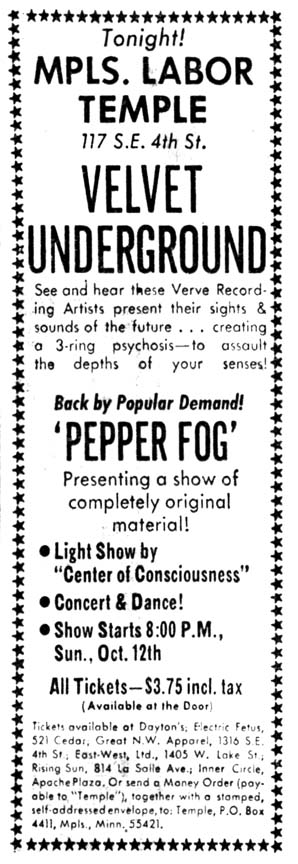
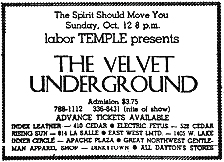
Minnesota Daily ad courtesy Robb Henry
Features:
- Concert promoter David Anthony Wachter remembers that Andy Warhol showed up for the show!
- Thomas Oss says that Center of Consciousness did the lights. “Lou Reed personally told me NO STROBES!!!”
- In an interview, band member Sterling Morrison remembers staying at the infamous Gopher Motel.
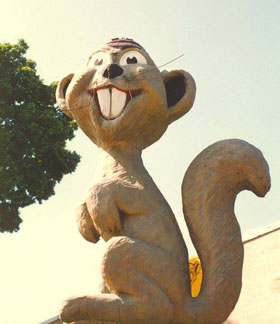
MINNEAPOLIS STAR, October 13, 1969
In a review rife with hippie lingo that was a little much, even for 1969, Walter Lide deemed the Velvet Underground “Outta Sight!” It’s hard not to quote the whole review.
Velvet Underground is outta sight. I got a rush just listening to them. … The last half hour saw the young, hip audience scream with pure pleasure … Lead singer Lew (sic) Reed has a voice that can best be described as a mixture of Bob Dylan and Rap Brown. Reed handles his guitar like a machine gun … Every once and a while, a rock critic will see a group that he is really excited about. Velvet Underground is just such a group.
Walter had this to say about local heroes Pepper Fog:
Peper (sic) Fog, the local group playing on the same bill as Velvet, was above average. It is good and probably would have left more of a lasting impression on the audience at the Temple had it not been billed with such a super far-out group as Velvet Underground.
Walter, Walter.
CONNIE’S INSIDER, October 18 – 25, 1969
Connie’s review was short and sweet. There was no review. Well, he said that the Velvet Underground played “some of the best music ever heard at the Temple,” but “Our reporter’s story wasn’t written in time” for this issue, so it would be in the next one. It wasn’t. I looked and looked! “Pepper Fog was also on the bill,” he said helpfully.
A LULL IN THE PROCEEDINGS
A note in the Daily, which must have been published between October 27 and November 1, 1969, read:
The Labor Temple has been conspicuously absent from the rock scene for the last two weeks and will be silent again this weekend. Promoter David Anthony, who was arrested for not allowing two plainclothes policemen to enter without a warrant, claims the hassle has been just too much. If they come out of court satisfactorily on November 5, the Temple will reopen with two shows a night and even bigger names.
As soon as his legal problems were resolved, David Anthony announced that “Rock” concerts (as the unbylined Star article put it) would resume at the Temple. However, the report also said that
Some of the unions with offices in the building reportedly are unhappy with the types of persons attracted to the building by the concerts. The hall will be used for Christmas parties for the next few weeks. (Minneapolis Star, November 5, 1969)
No further concerts were held in 1969.
TWIN-TOWER LABOR CENTER PLANNED?
Another strange thing going on around this time was that the powers-that-be who owned the Labor Temple were contemplating tearing it down and building an $8 million, twin-towered labor office building and shopping center on the site, to be called the United Labor Centre. It would have 10 floor and a 6 floor towers and provide more than 150,000 square feet of office space, a 1,500-seat auditorium, meeting halls, and commercial facilities. The Labor Temple Association had been planning this move for about two years. Never happened.
LABOR TEMPLE, 1970
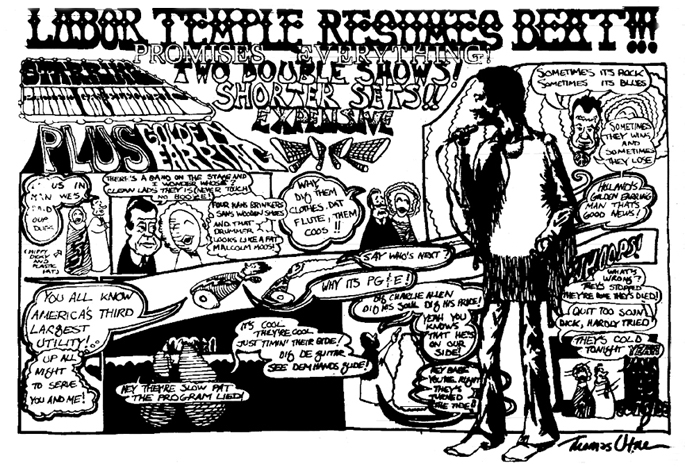
Tom Utne, Hundred Flowers
David Anthony resumed booking bands in the Labor Temple in 1970. This time lights were by Nova. See a collage of more ads from Robb Henry’s blog.
PACIFIC GAS & ELECTRIC, GOLDEN EARRING, AND BOBBY KOSSER – January 18, 1970
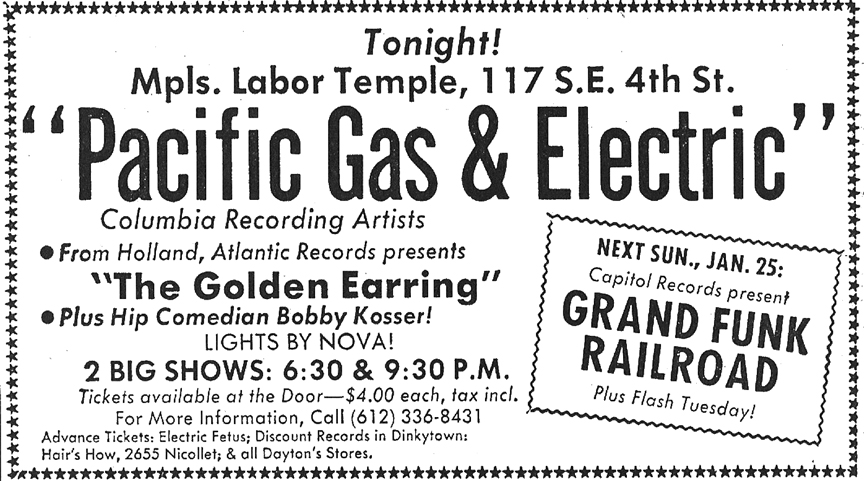
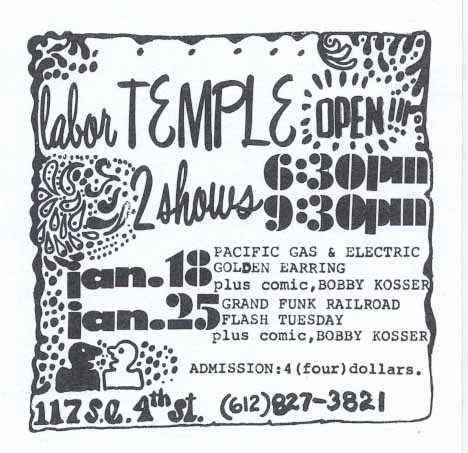
Minneapolis Flag, January 16, 1970
The ad below is from the Minnesota Daily, via Casper Roos, a Dutch fan of the Dutch band Golden Earring.
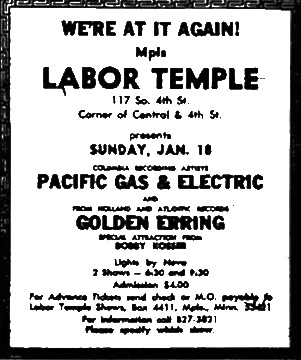
Casper says:
These [concerts, January and March, below] were performed during the second “The Golden Earring “USA tour. Their first tour was in May 1969. This second tour was to promote their just released “Eight Miles High” album (on Atlantic label) as promoted on the [March] Labor Temple ad. Golden Earring is still performing but really broke through in the States with their 1974 hit “Radar” Love from their album “Moontan.” That album and “Radar Love” single were promoted during their third (May 74) and fourth 1974 USA Fall tours. These tours meant the USA breakthrough for the band. “Radar Love” is nowadays a highly respected road song…. the track itself has been covered over 600 times by many bands and artists.
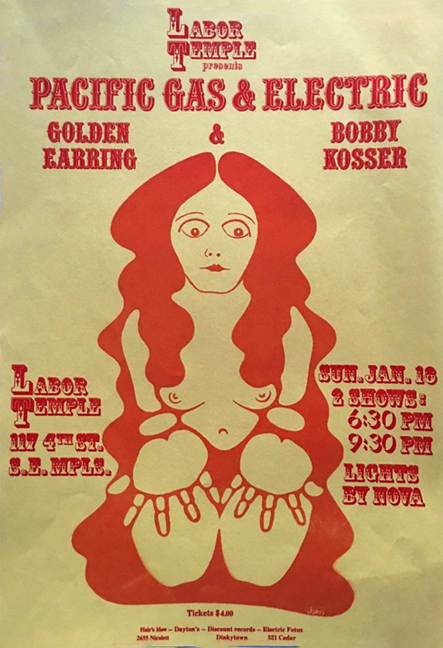
January in Minnesota can be hard on anyone, but the report is that Golden Earring showed up in a Mercedes van powered by diesel, which froze and wouldn’t start after the show.
Kosser was described in an ad as a “hip comedian who just finished a tour with Spooky Tooth and Savoy Brown.” (Minneapolis Tribune, January 11, 1970)
GRAND FUNK RAILROAD, FLASH TUESDAY, AND BOBBY KOSSER – January 25, 1970
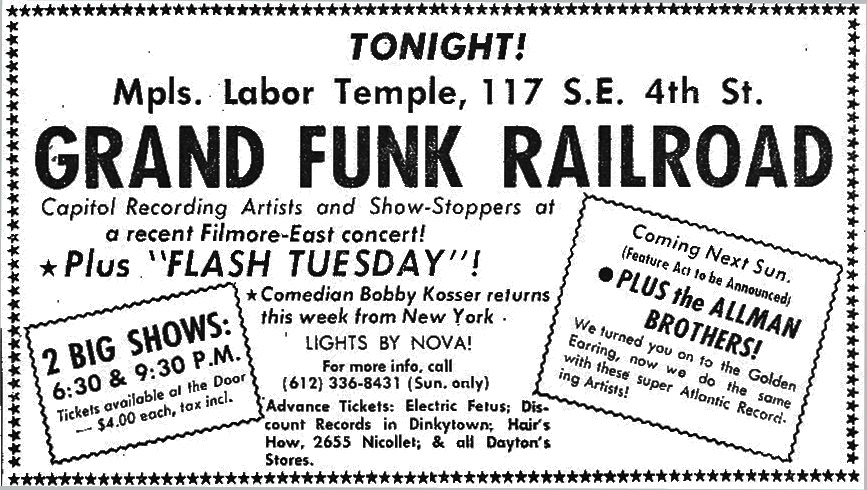
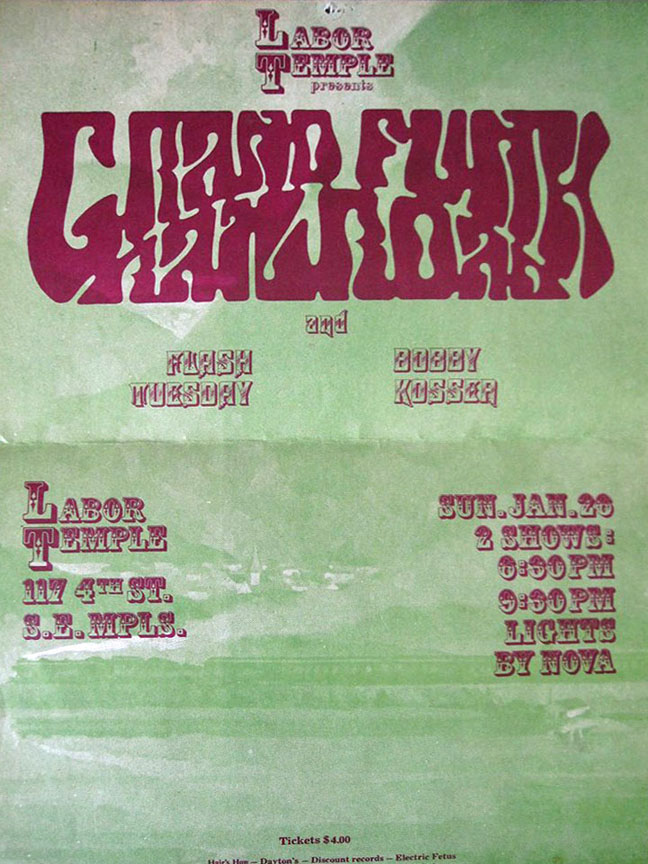
Courtesy Rich Aguirre
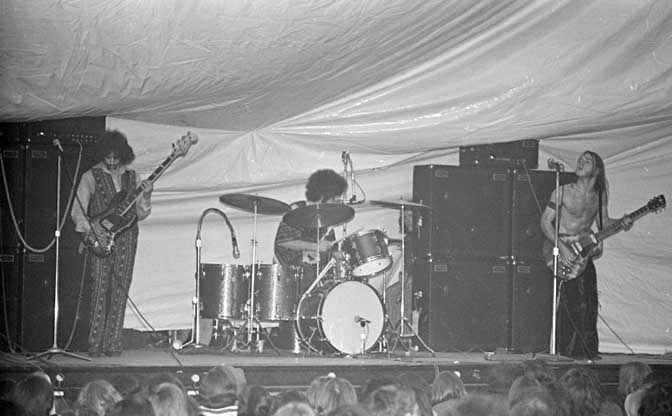
Grand Funk Railroad – Photo Copyright Mike Barich, St. Paul
This was Grand Funk’s first Minneapolis appearance. The concert sold out in 2-3 hours and David Anthony remembers the band to be really LOUD.
The opening act was Flash Tuesday, basically Jokers Wild with a different drummer. Lonnie says, “Grand Funk’s manager offered us recording contract. We were already in the throes of rock star angst and would soon break up, so David Anthony said no to the deal… so goes life.”
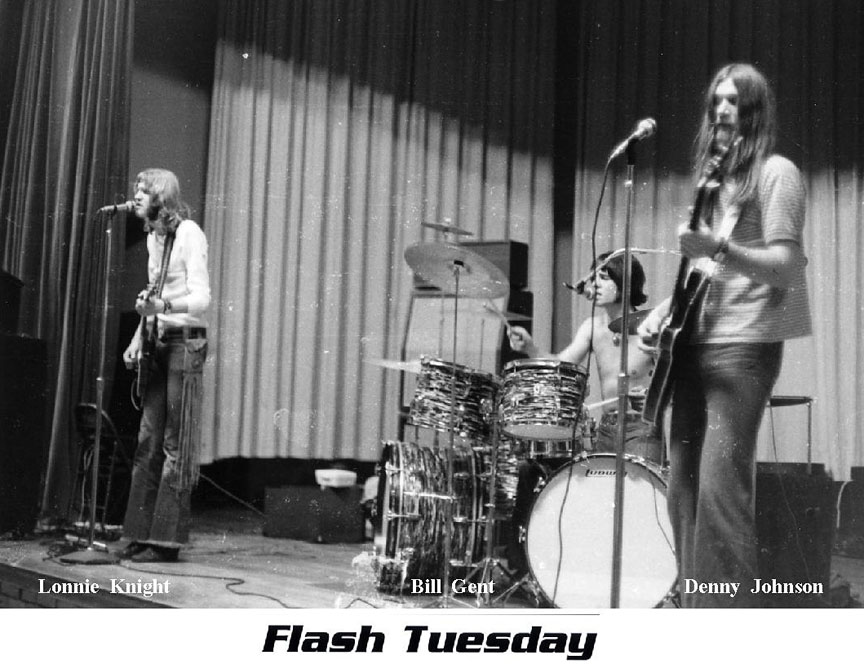
Photo Courtesy Lonnie Knight
ALLMAN BROTHERS, JOHN HAMMOND, JR. – February 1, 1970
This was reportedly the Allman Brothers’ first appearance above the Mason-Dixon line, but that is not borne out by a website with tour date information. Of course, that website has them in Charleston when they were here in Minnesota… A reliable source says that they’d been to Boston in May 1969, played regularly along the Eastern Seaboard that entire year, played Ludlow Garage in Cincinnati in December 1969, and this was only their third show in the Midwest.
According to David Anthony, he persuaded them to come to Minnesota for $500.
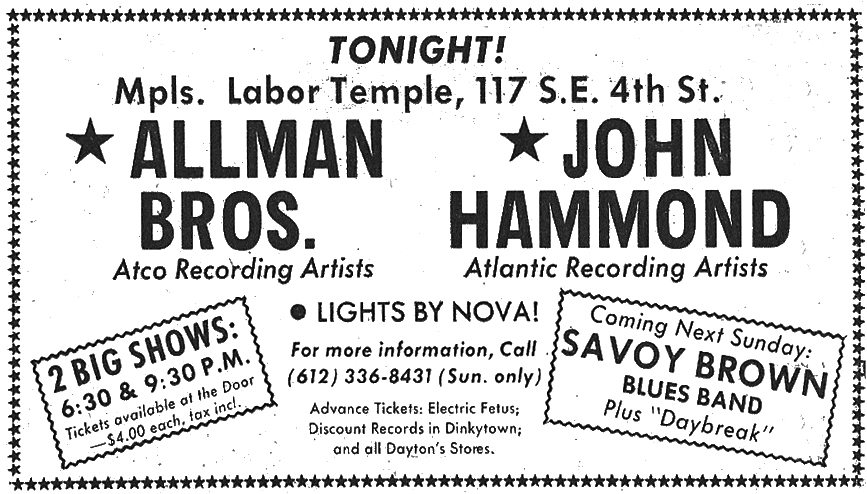
MINNESOTA DAILY, February 6, 1970
Perhaps because of the weather, Ron Dachis noted that only about 100-200 people were at the show. John Hammond opened, accompanying himself on guitar and harmonica. Dachis gave Hammond high marks for his good, earthy, Snaker Ray-type blues.
The Allman Brothers featured two drummers, and they stretched Donovan’s “There is a Mountain” to 20 minutes. Hammond returned to jam with the Allmans, and Dachis dug all of it. “There was no phony bullshit and no screaming or jumping aaround Just really good stuff.”
The only disappointing part of the evening was the Temple crowd. Some got up prematurely to leave, others were inattentive, and most of the others seemed to be lukewarm toward the acts. These guys deserved better. They had some great material, fine arrangements, and excellent musicianship. They were not overly loud or obnoxious. It’s a shame they weren’t better received.”
Dachis loved it, though; the title of his review was “No-bullshit-blues at the Temple (finally).”
The lineup of the Allman Brothers was:
- Greg Allman (called “Gregory” in Dachis’s review) – keyboards
- Duane Allman – guitar
- Dick Betts – guitar
- Butch Trucks – drums
- Jai Johnny Johanson – drums
- Barry Oakley – bass
MINNEAPOLIS TRIBUNE, February 2, 1970
Oh, Allan Holbert was showing his squareness again, titling his review “Allmond Brothers Perform at Temple.” Typo? He did it again in the first line! He counted the crowd at about 200. But give him this: ”
But judging from their sound I think it would be safe to predict that the group is not going to have to put up with small audiences much longer. With a little luck and proper promotion they could become one of the top rock names in the country.
He notes that their songs do not all sound the same, and “someone in the group has done some excellent arrangements.”
He didn’t do much but describe Hammond, but liked Nova’s light show, “which throbs and flashes in full color and which gets better every week.”
Stephen Pfeiffer recalls:
It was an ungodly frigid Sunday night (-30 below). Only around 100 people made it to the show to see an unknown southern rock band play their first show in Minneapolis. I do remember having to lock my car with the engine running to ensure my getting home after the show.
Billy Hallquist remembered setting up the sound for the show, and that since there were so few people, the first show attendees could stay for the second show. “During Hammond’s second set, the Allmans sat on the floor with the audience and watched him in awe. Then invited him to jam with them at the end to Donovan’s “First There is a Mountain.” They were pretty down to earth.”
SAVOY BROWN AND DAYBREAK – February 8, 1970
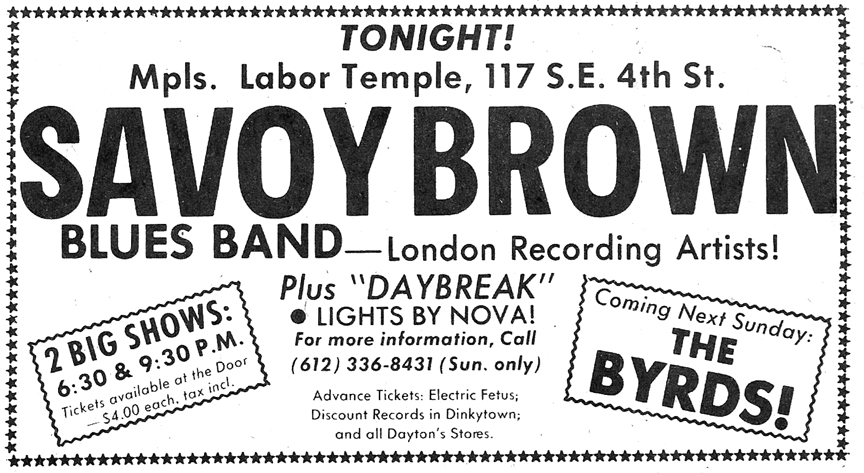
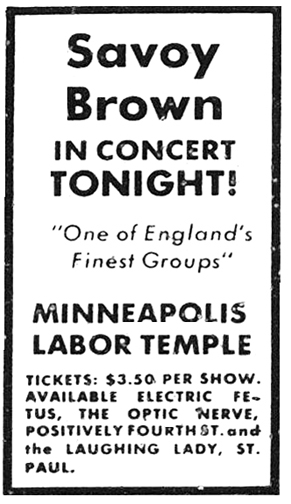
Minnesota Daily ad courtesy Robb Henry
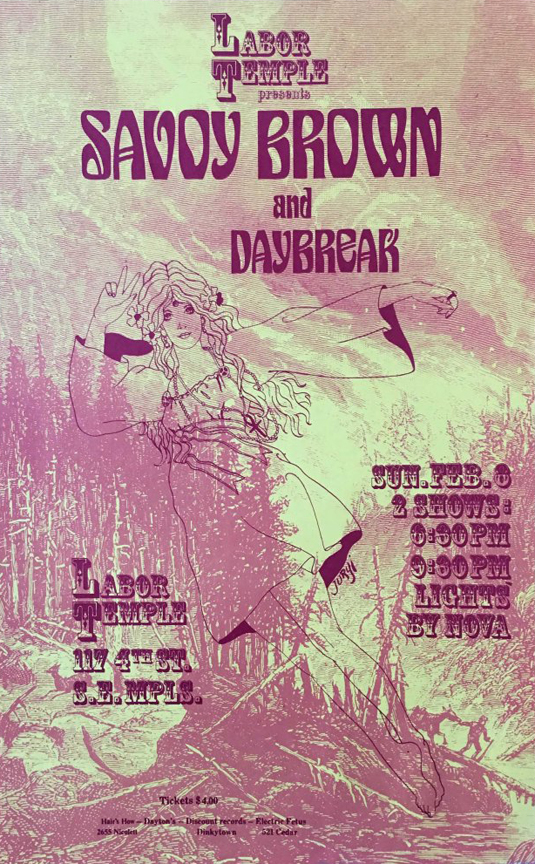
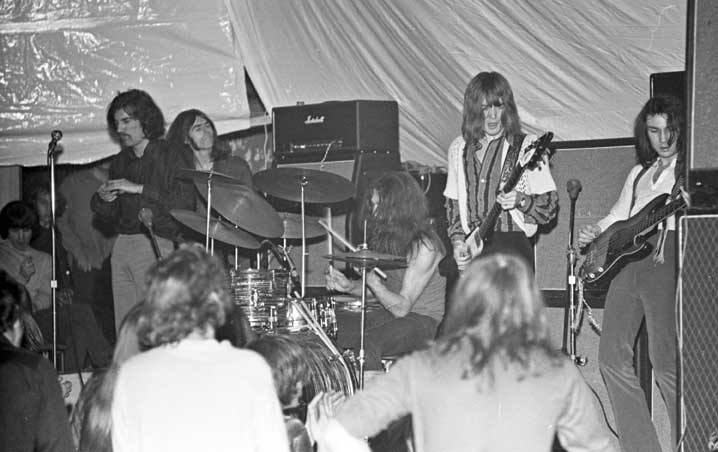
Savoy Brown – Photo Copyright Mike Barich, St. Paul
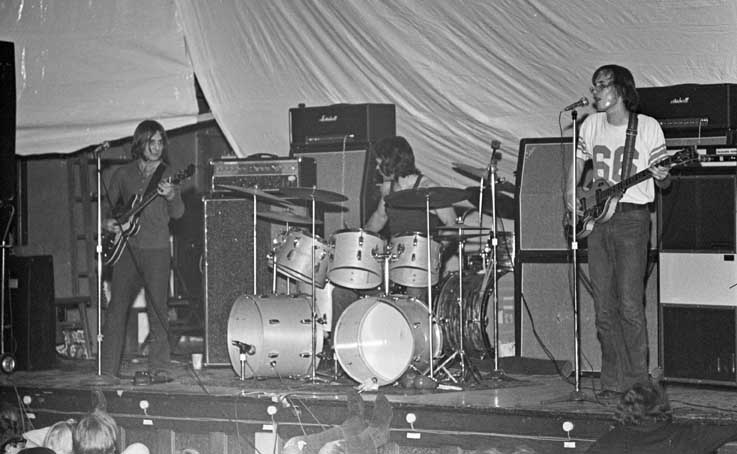
Daybreak – Photo Copyright Mike Barich, St. Paul
MINNEAPOLIS TRIBUNE, February 9, 1970
Will Shapira noted that this was Savoy Brown’s third American trip (second trip to the Temple). The audience was “small was enthusiastic.” The group’s personnel had changed, but the mainstays were lead guitarist Kim Simmonds, and vocalist Chris Youlden. Other members were drummer Roger Earl, Tommy Stevens on bass, and Dave Peverett on rhythm guitar. The band did a 15-minute “Louisiana Blues,” and a piece simply called “The Boogie.”
Local group Daybreak was made up of Lyn LaSalle, lead guitar; Howie Bursch, drums; and Dave Hesse, bass. Despite some equipment problems, they delivered a good set, featuring a LaSalle original “The Keeper.”
Shapira liked Nova’s light show, but not their intermission film, a British melodrama about outer space.
MINNESOTA DAILY, February 13, 1970
Well, reviewer Ron Dachis didn’t like Daybreak. “They unleashed a barrage of noise, screaming out one uneventful song after another. A raving bass player and nondescript drum solo added to the abuse. Enough said.”
Savoy Brown, however, boogied quite handily, playing everything from “Hernando’s Hideaway” to “Purple Haze” to the boogie beat. Also some oldies: “Whole Lotta Shakin’ Goin’ On,” “Little Queenie,” and “Shake, Rattle, and Roll.” Kim Simmonds and Chris Youlden were the only original members of the group. Dachis was disappointed that the band presented no new original material, but in the end, “an enthusiastic crowd and a solid rocking band made for a good evening’s entertainment.”
The Nova Light Show was “typical,” but Dachis did like the W.C. Fields flick they showed at intermission.
BYRDS AND TEAGARDEN & VAN WINKLE – February 15, 1970
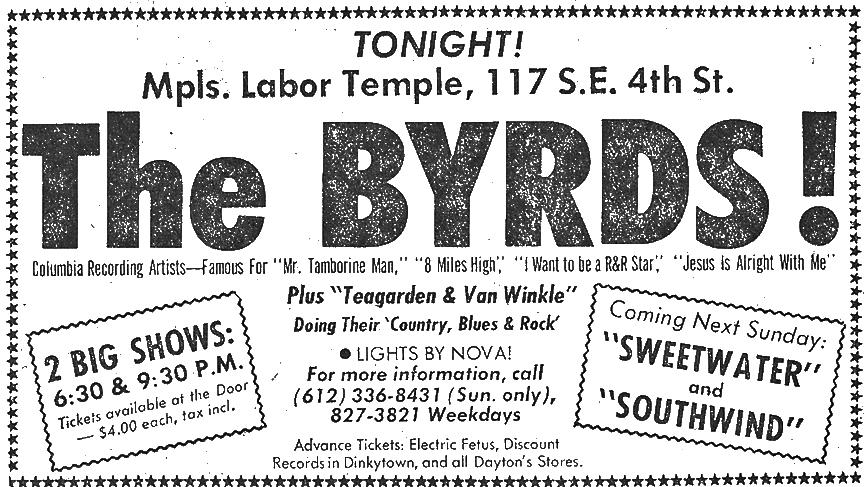
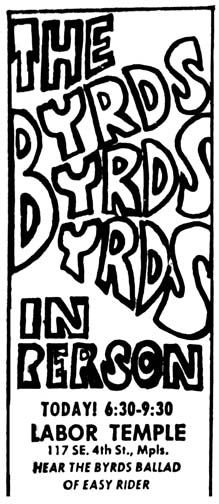
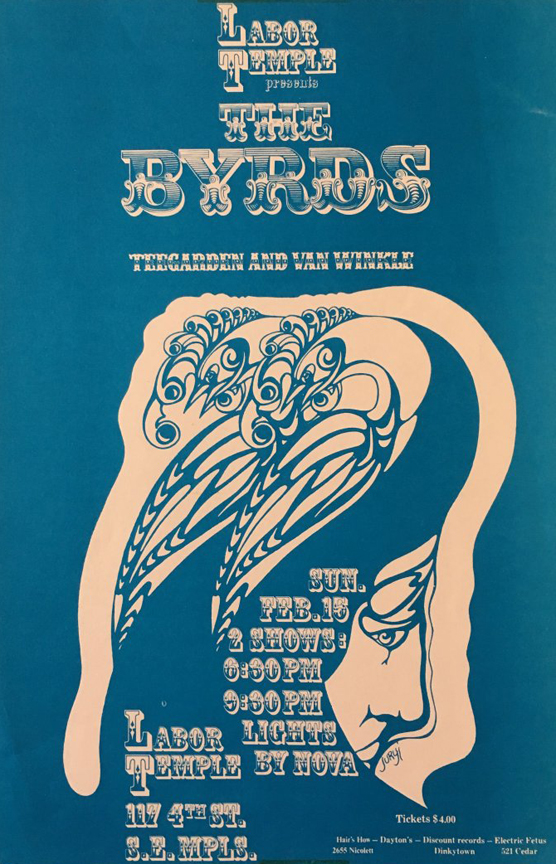
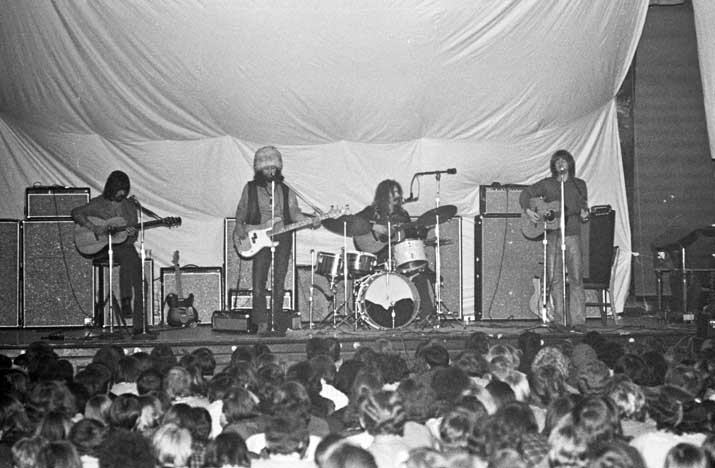
The Byrds – Photo Copyright Mike Barich, St. Paul
At this point Roger McGuinn was the only original Byrd, as Gene Clark, Chris Hillman, and David Crosby had moved on. The new members were:
- Gene Parsons – drums, harp
- Skip Battin – bass
- Clarence White – lead guitar
MINNEAPOLIS STAR, February 16, 1970
Peter Altman noted that “a very big audience,” about 3,000 to 5,000 people, showed up for the two shows. The groups had three guitars and a drum – no horns, no piano, no organ. Roger McGuinn was the only original Byrd, ably supplemented by Skip Battin on bass and Clarence White. A typo may have obscured the other member’s name. Altman opined that the group was better instrumentally than vocally.
He also said that the Byrds’ “musical formula has remained constant,” which was “unabashedly white, Nashville-inspire and rock based. There are no phony blues, no adolescent pretense at jazz-rock, no attempt to make the audience say the group plays just as well as if they were black, no irrelevant polemics.” The first set played about an hour and a half.
Altman found Teagarden and Van Winkle’s sound derivative of the Band, and their humor “not too far from Homer and Jethro’s.”
MINNEAPOLIS TRIBUNE, February 16, 1970
Will Shapira described the Byrds’ sound as a “deeply satisfying country blues.” Their new hits were satisfying, but their medley of Byrd hits were more of an obligation.
Teegarden and Van Winkle “generated some powerful gospel rock. Van Winkel, on organ, blasted out some stirring Jimmy Smith chords while Teegarden added a throbbing drum solo, both on “A Walk on the Wild Side.”
MINNESOTA DAILY, February 20, 1970
The group played some of the Byrds’ early repertoire, but reviewer Thomas Utne liked their “new stuff that they sing with pleasure and pick with pride. They are casual, smooth, harmonic, funky (but not hokey), and fun.”
Teagarden and Van Winkle turn out to be a drum-organ duo from Tulsa. Utne: “They managed to butcher Donovan’s ‘Season of the Witch’ almost as grossly as the other twenty versions of it. Their long between song raps are much more fun to listen to than their drawn out instrumental renditions of everything. Van Winkle’s Okie accent is unbelievable.”
It was at this show that West Bank folk singer Ken Schaffer began a run as the emcee. He sang five songs before the first set, and one song before the second.
SWEETWATER AND SOUTH WIND – February 22, 1970
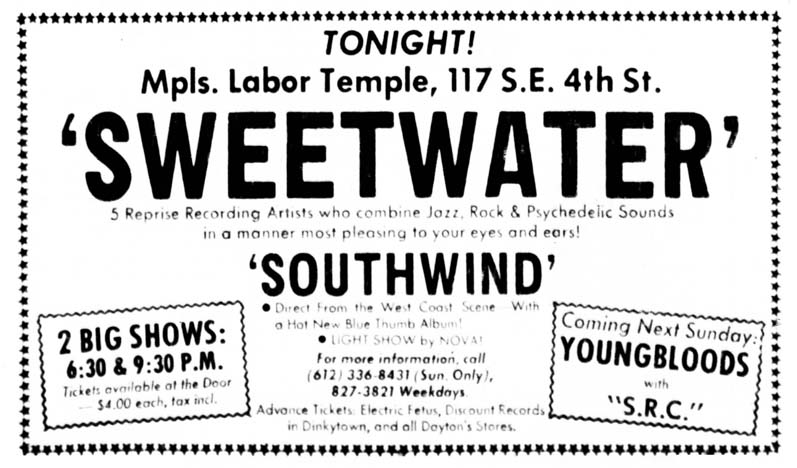
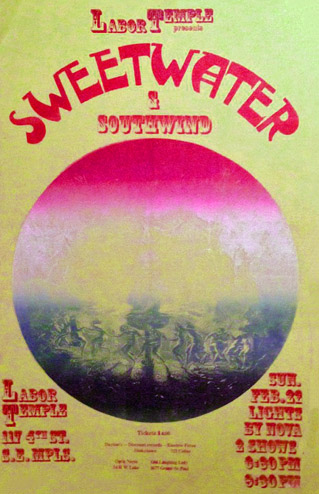
Poster courtesy Paul Pash
Sweetwater performed without Nansi Nevins, who had had her debilitating car accident the previous December.
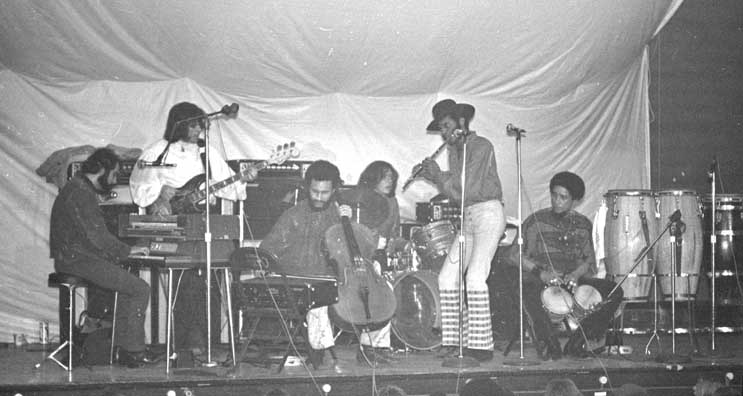
Sweetwater – Photo Copyright Mike Barich, St. Paul
South Wind played country rock.
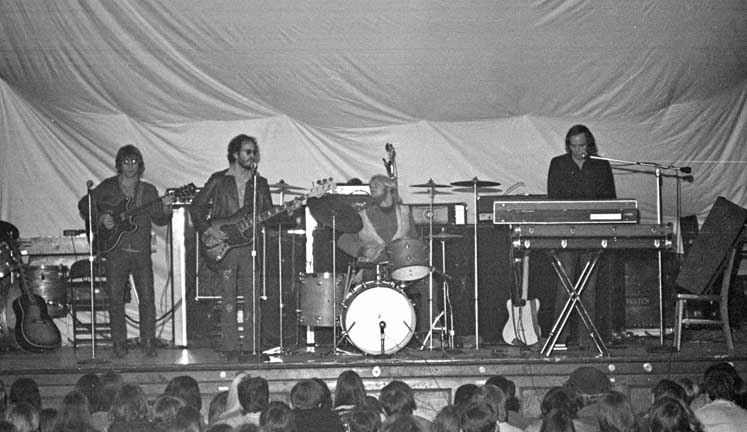
South Wind – Photo Copyright Mike Barich, St. Paul
YOUNGBLOODS AND S.R.C. – March 1, 1970.
S.R.C. was from Detroit and had a few albums out on Capitol Records.
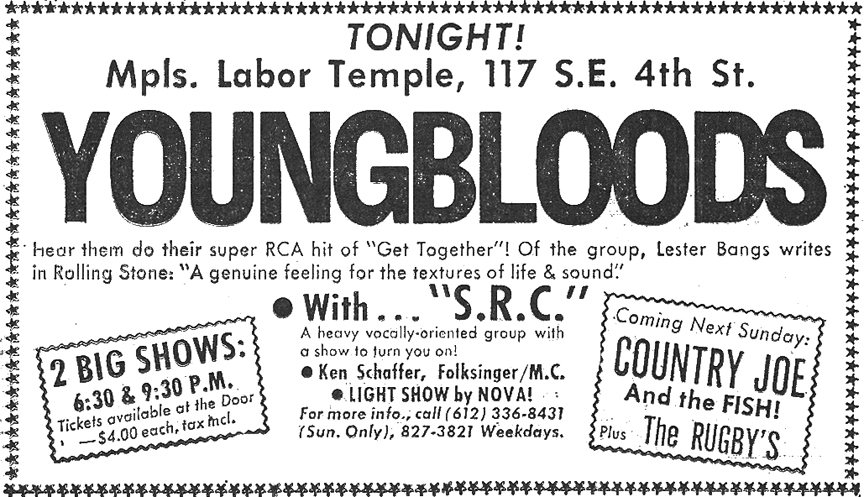
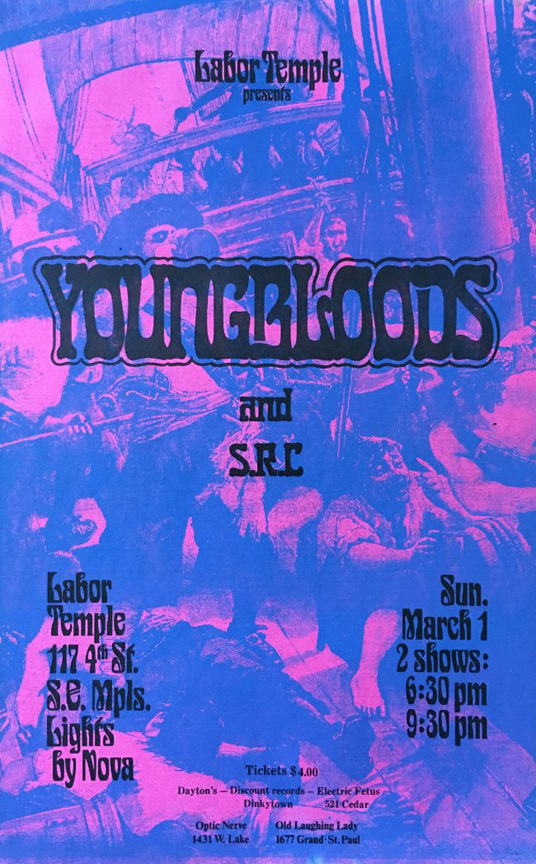
MINNEAPOLIS STAR, March 2, 1970
There was only a crowd of 200 for the first show. Dodd Lamberton described their show as “controlled and well-balanced.” The musicians were identified as Jesse Colin Young on bass, Banana on guitar and electric piano, and Joe Bauer on drums.
The Youngbloods have changed from a happy-sounding straight rock group to one which dips into many musical styles: rock, blues, country-western, and folk with a bit of social commentary thrown in.
Their concert showed their diversity. Banana did an instrumental on the banjo, and Young shone as he soloed on an acoustical guitar, pleading with the audience to “stop killing one another.” A friend of the band, a harmonica player named Earthquake, joined the group at one point for a blues jam session.
Banana’s piano work showed an amazing combination of technical clarity and harmonic soundness. Young’s singing of “Sunlight” and “Darkness, Darkness” from the group’s third album drew long ovations from the responsive crowd. Bauer’s rhythm, whether on the drum set or a congo (sic) drum, never wavered.
SRC’s “volume drowned out any pleasing effect their music might have had.”
COUNTRY JOE AND THE FISH AND THE RUGBYS – March 8, 1970
The Rugbys were from Kentucky.
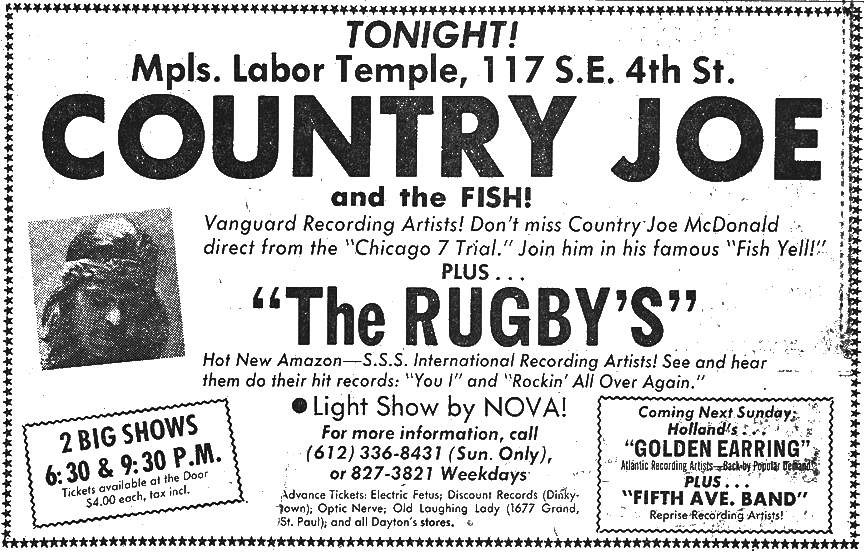
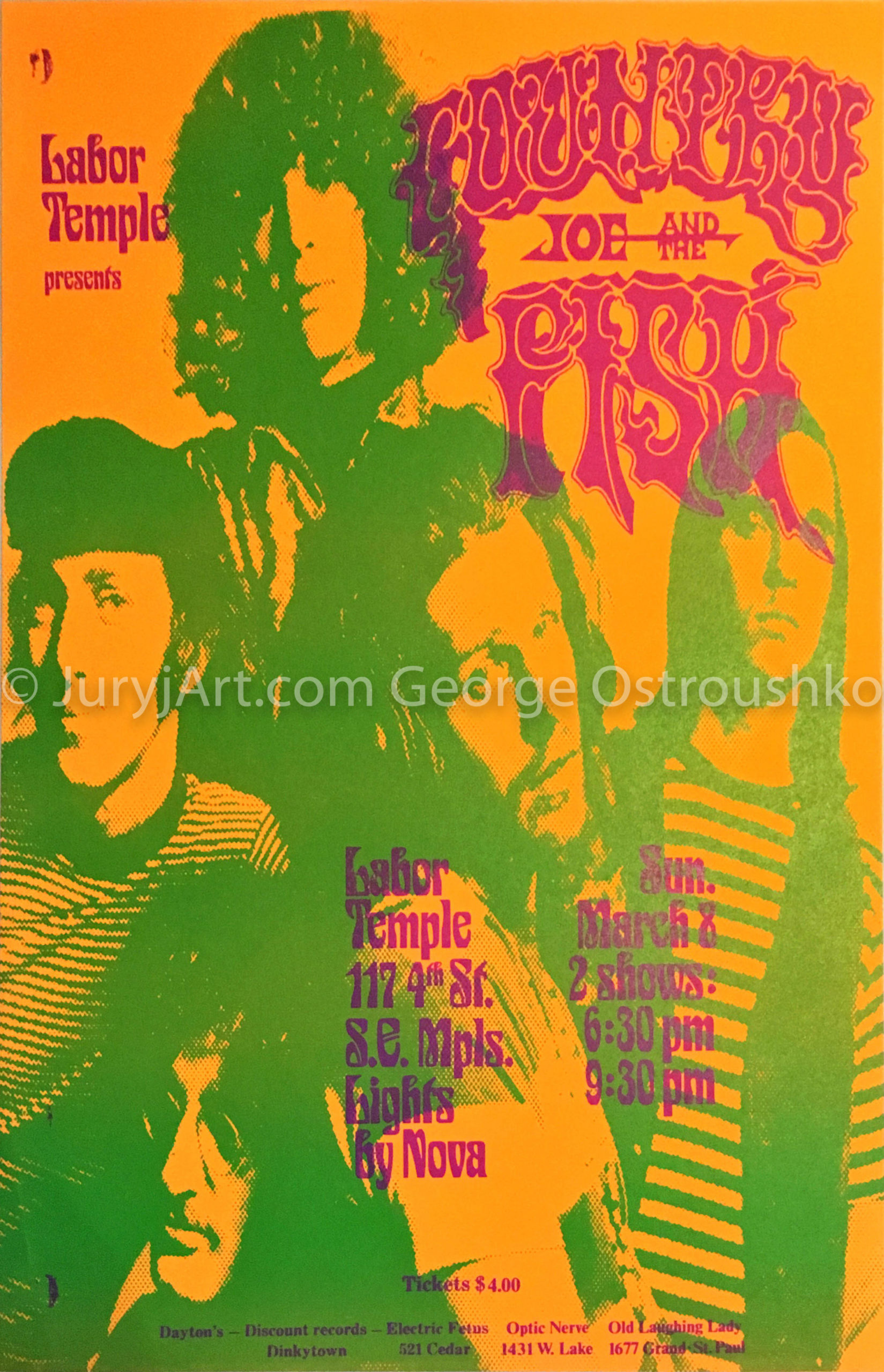
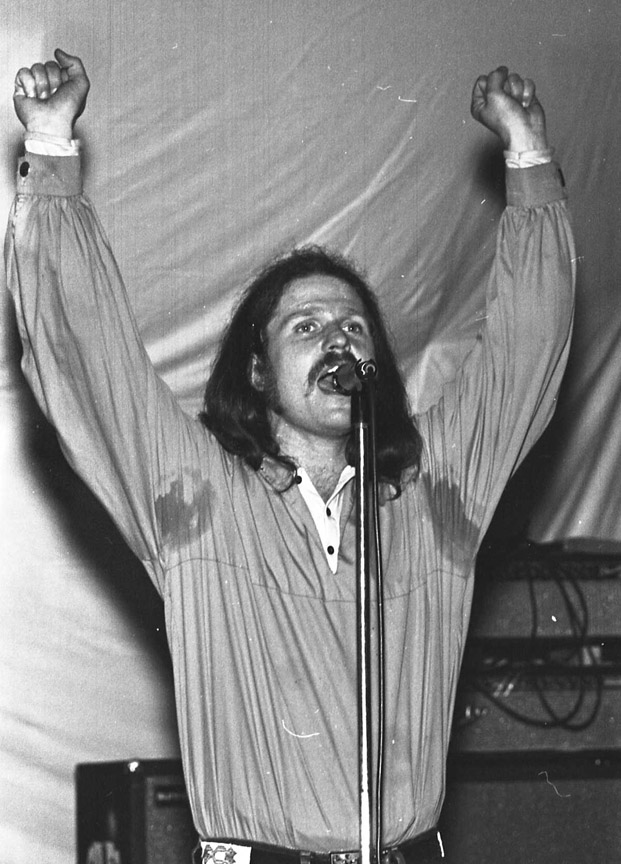
Country Joe McDonald – Photo Copyright Mike Barich, St. Paul
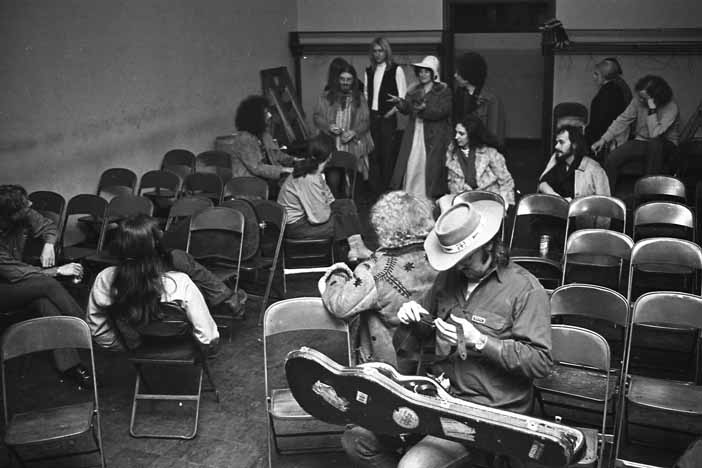
Country Joe – Photo copyright Mike Barich, St. Paul
MINNEAPOLIS STAR, March 9, 1970
Marshall Fine declared that “there was a time about two years ago, when I would have traded my little brother to see Country Joe and the Fish in concert.” But after a “massive personnel change,” the music came out “boring” and “hackneyed.” Even Country Joe seemed bored by the whole thing, and was unable to get the audience to join in a singalong to Woody Guthrie’s “Roll On Columbia.” He no doubt would have had better luck with the “Fish Yell.” The band was finally able to bring the crowd to life with an old fashioned rock ‘n’ roll number, “Rockin’ Around the World.”
Fine found the Rugbys competent but with little or no showmanship. The “amazed the crowd with their ability to play solid rock and still die in a blaze of mediocrity.”
GOLDEN EARRING AND THE FIFTH AVE. BAND – March 15, 1970
Light show by NOVA.
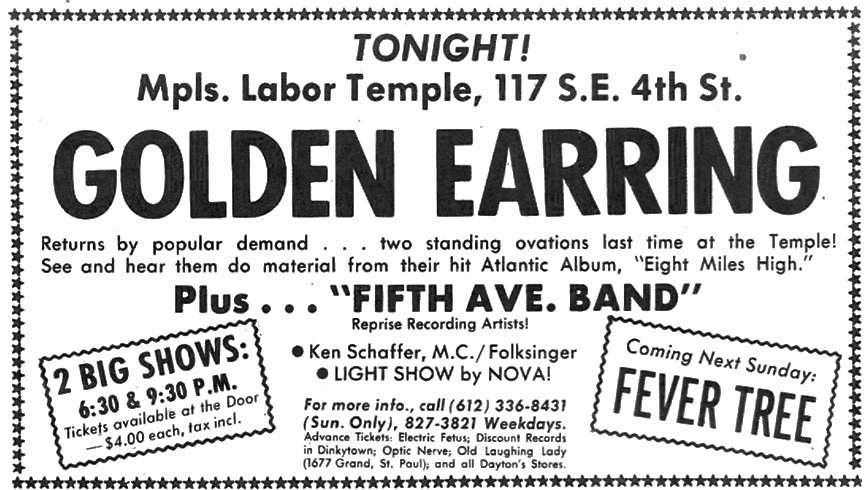
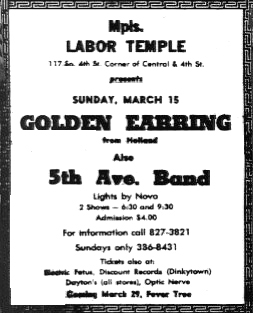
Courtesy Casper Roos
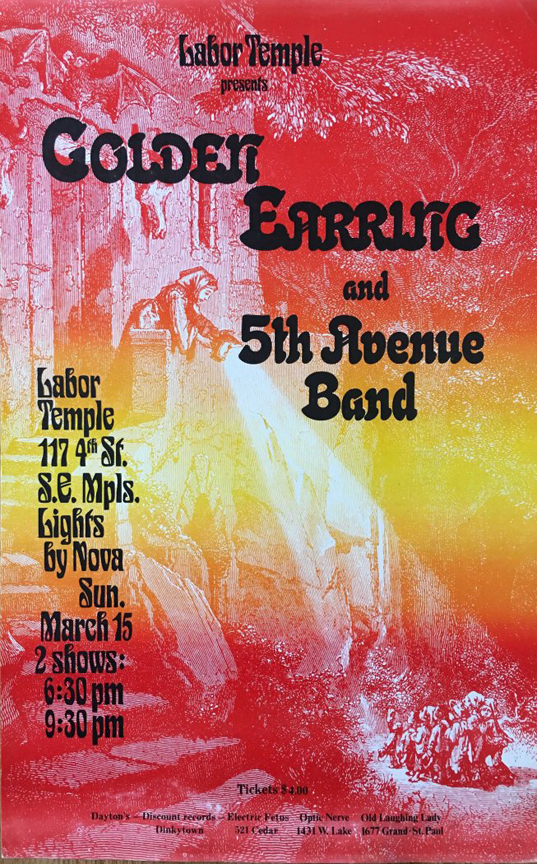
MINNEAPOLIS TRIBUNE, March 16, 1970
“Earring Band” Featured in Rock Concert,” was Will Shapira’s headline. He didn’t have much to say about this Dutch band, actually:
Their first set last night was short but tight. George Kooymans, lead guitarist, took several good blues-infused solos while Barry Hay, flute, was beautiful on a ballad on which he produced some haunting effects through an electronic echo device.
Shapira seemed more interested in the opening acts, noting that Ken Schaeffer sang two series of ballads very well. Fifth Avenue Band from New York City had been on the Dick Cavett Show, but one group member said “TV makes you do all kinds of crappy things.” But here at the Temple,
They hauled everything out of their bag: soft rock, hard rock, country, and bossa-nova – all well done. “Calamity Jane,” a hard rocker, was the high point, featuring a strong guitar work by Jon Sholle.
JOHNNY WINTER AND THUNDERTREE – March 22, 1970
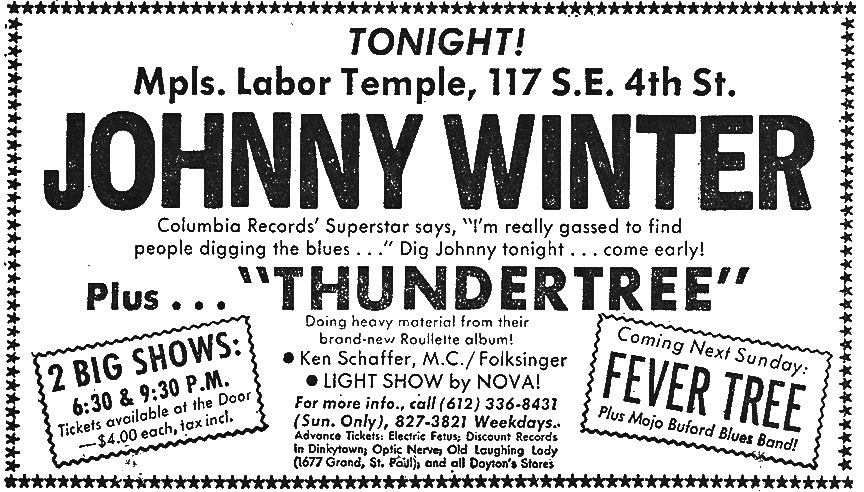
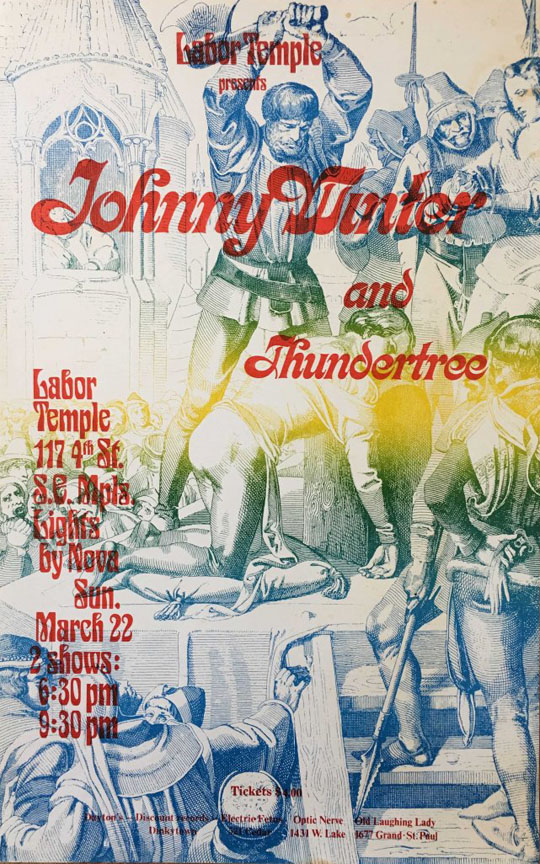
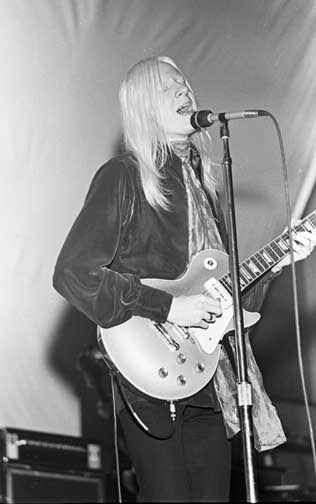
Johnny Winter – Photo Copyright Mike Barich, St. Paul
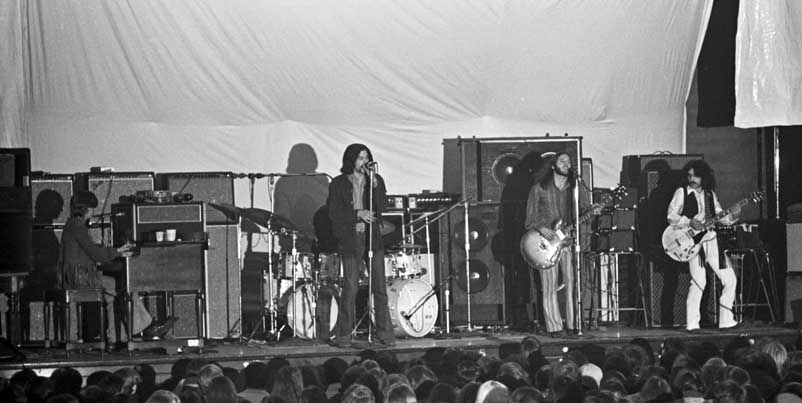
Thundertree – Photo Copyright Mike Barich, St. Paul
CONNIE’S INSIDER, April 11, 1970
Johnny got a roar of welcome from many of the 800 blues freaks crammed into the hall, reported Connie. Winter came on strong from the star, belting out solid, funky blues riffs “that have catapulted him to the pinnacle of the rock world.” Soon brother Edgar joined him on stage with his alto sax, singing and wailing some fantastic blues and jazz riffs. Edgar moved to the organ and electric piano and they launched into a moody “Tobacco Road.” Johnny did “Rollin’ and Tumblin’ as an encore. David Anthony said that 1,000 people had to be turned away for Winter’s second set.
Thundertree’s set was short but strong, with inventive and original songs. They did their signature “Sixteen Tons.”
MINNEAPOLIS TRIBUNE, March 16, 1970
Will Shapira described the music as loud, gutty, and diverse: ’50s rock ‘n’ roll, “Southern-fried soul,” and some surprising and pleasing side trips into jazz. Note: Shapira probably wrote the shorter synopsis that was in Connie’s Insider.
MINNEAPOLIS FLAG, April 10, 1970
The review was short but decisive:
2,000 delighted Temple-goers screamed and freaked during the March 22nd performance of Johnny Winter and his hard group. Edgar his brother came on as a terrific crowd-pleaser and a most versatile and original musician. Everyone enjoyed their stoned selves.
Thundertree, the warm-up group, were at their best – pick up their album – you may dig it.
BILLY HALLQUIST
Billy Hallquist of Thundertree remembered:
When Thundertree opened for Johnny Winter at the Labor Temple, he wanted to use his own P.A. The delay caused us to cut short our set at the first show. Johnny was apologetic. Before the show, he sat next to me in the dressing room and was playing the lick to a Blind Faith song over and over (wrong). I struggled mightily whether I should correct him or remain silent. After several agonizing minutes, I chose silence. During the second show we got to play our entire set, including our 30 minute version of “I’m a Man.” During my extended solo, I noticed that Johnny was standing on the side of the stage groovin’ along with me. I must admit I felt a little uneasy watching him watch me. After the show, he played my blonde 335 and offered to buy it. Never had the opportunity to meet or see him perform again.
FEVER TREE AND MOJO BUFORD BLUES BAND – March 29, 1970
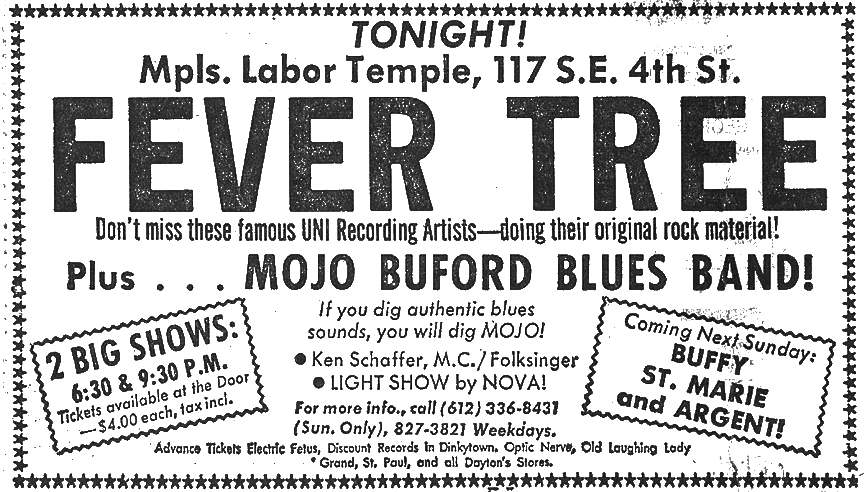
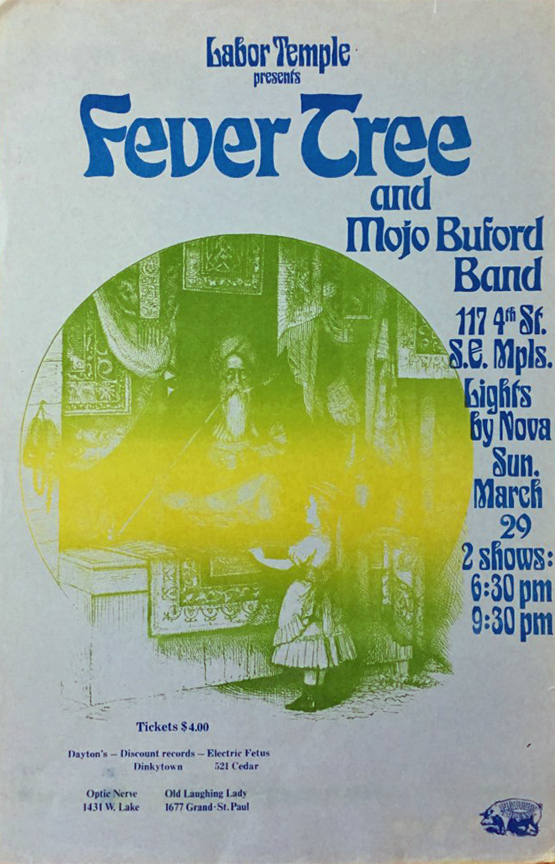
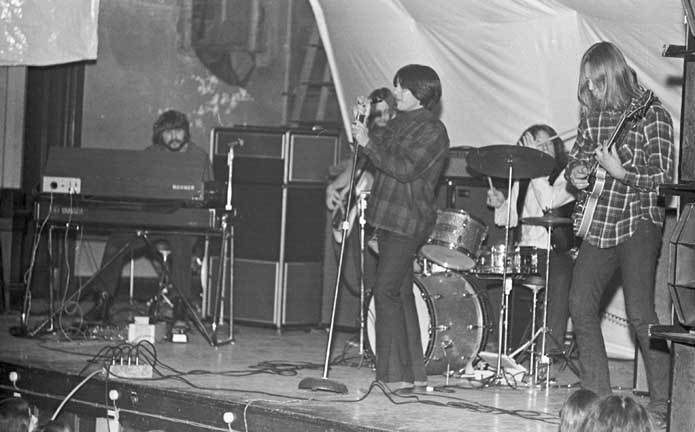
Fever Tree – Photo Copyright Mike Barich, St. Paul
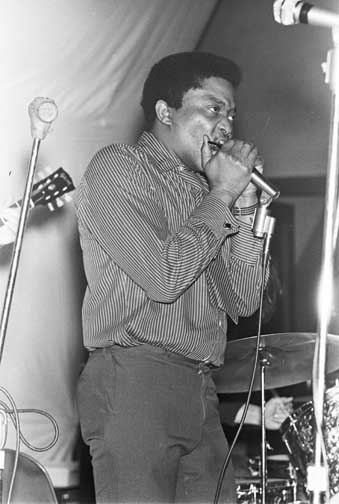
Mojo Buford – Photo Copyright Mike Barich, St. Paul
BUFFY SAINTE-MARIE AND ARGENT – April 5, 1970
This show was cancelled; there is a poster for Buffy Ste. Marie for May 3, 1970 below. That show was also cancelledd.
SMALL FACES AND ALICE COOPER – April 19, 1970
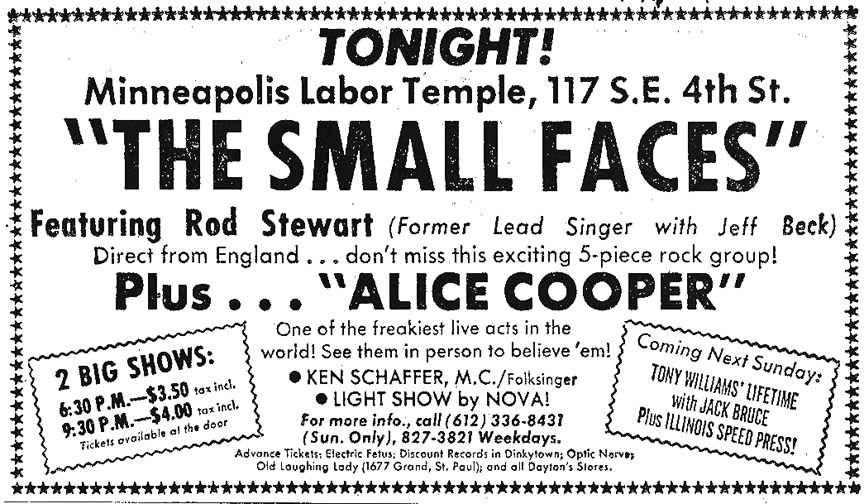
The Small Faces had actually disbanded in 1969 when founding member Steve Marriott left to form Humble Pie. The remaining members were joined by Ronnie Wood on guitar and Rod Stewart on vocals, and the group was renamed the Faces – except that the Faces’ first album was credited to the Small Faces in the U.S. By 1970 they preferred the name Faces, but seemed to be stuck with the “Small” for a little longer. (Oh, a pun..)
George Ostroushko created most of the Labor Temple’s posters, and remembers this about the one shown below:
I was a huge fan of the Small Faces, and when Steve Marriott abruptly left to start Hubble Pie I was deeply saddened and hurt but, not nearly as hurt as when I found out that the Small Faces reformed as the Faces with new members and one of those members was Rod Stewart…..I had met Rod about a year earlier when he played with Jeff Beck and I found him to obnoxious and arrogant, so when I found out that they were playing at the Temple and that my poster was to represent that show, I decide to put Small Faces on the poster rather than the Faces. No one knew about my little sabotage, or at least no one said anything, until the night of the show, I was sitting behind stage with Ronnie Lane and Kenny Jones and I told them what I had done and why. We had a good laugh about the poster over a couple of joints. Ronnie Lane was and still is one of my favorite writers and singers of all time. Miss you Ronnie, you were one of the greats!
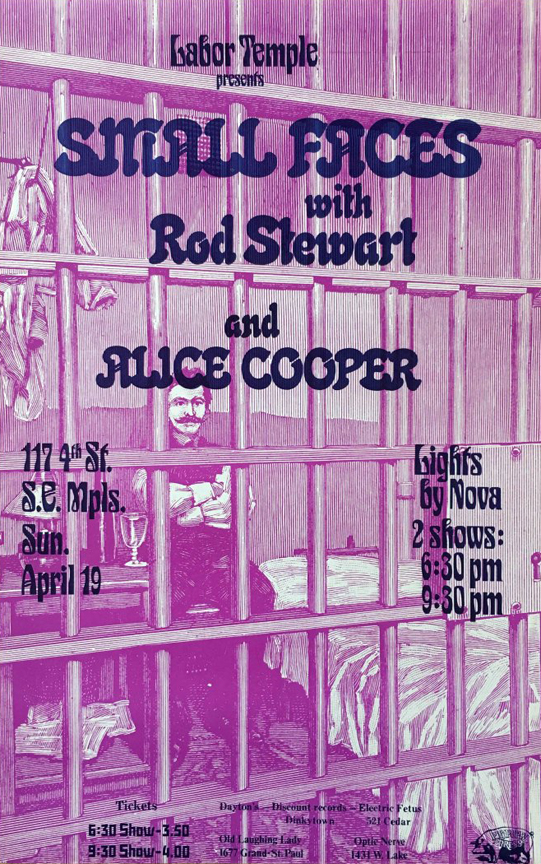
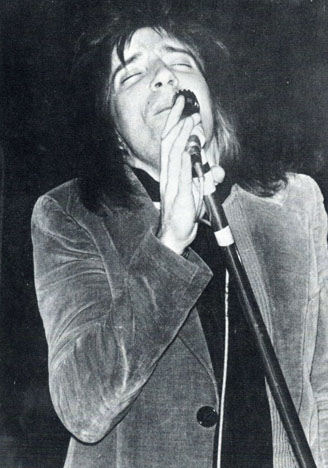
Rod Stewart – Photo Copyright Mike Barich, St. Paul. As printed in Connie’s Insider, April 1971
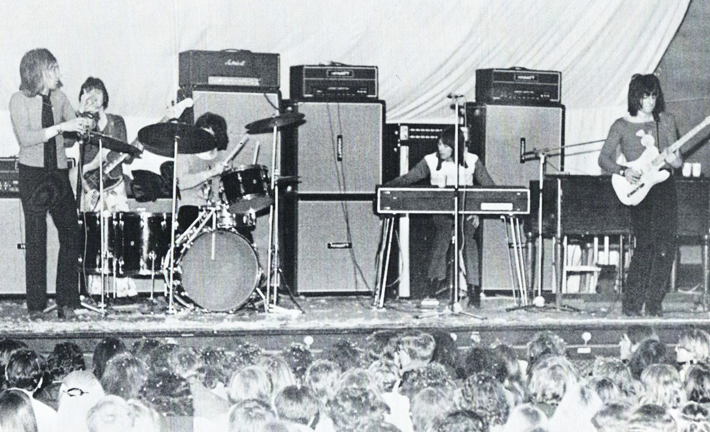
Faces – Photo Copyright Mike Barich, St. Paul
HUNDRED FLOWERS
Alice Cooper led off and the combination of some lousy music and their wildly sensationalistic clothes (foils, whips and tits) made it quickly apparent that they’d better put on a pretty big show.
They saved most of their energy for the last song and I’ll bet they’ve gotten it on a lot better before. The song was a little kids’ nightmare. All these freaks with ballroom masks and hair down to their knees like boogey men running around the stage with their axes and then charging into the crowd.
Our friend Captain Alice capped it off by ripping two feather pillows and blowing smoke (and feathers) all over the crowd. F**K YOU (to the tune of AH CHOO), Alice. (Not to be mistaken for a chauvinist’s epithet.)
The Small Faces of Itchicoo Park and funny-shaped album cover fame were in the process of breaking up after the demise of their record company, but were saved in time by Rod Stewart and Ron Wood of the the Jeff Beck group. Stewart and Wood, et. al., conserved their stuff too until the lights went on, after which they played three or four long songs, and Stewart finally started cookin.’
MINNESOTA DAILY, April 24, 1970
Ray Olson’s review was a little more scathing. Alice Cooper’s music was “all blaring chords and unremarkable singing with banal lyrics to boot.”
Olson reported that the headlined group was introduced as Rod Stewart and the Small Faces.” Stewart corrected the MC by saying “We’re just the Faces.” Olson reported on the set list:
- Wicked Messenger
- Devotion
- Evil
- Flying
- Pineapple and the Monkey (described as an “elephantine cakewalk”)
- Around the Plynth
- Encores of a “mean blues shuffle” and then
- Three Button Hand Me Down
The audience didn’t recognize anything they knew, and applause was light. Also, their sound system stunk. The Faces’ first show was worse than Alice Cooper’s.
During the second show, Cooper’s
music was no better than before but their theatrics mounted the heights of inanity. They concluded their act with a “science fiction number” during which they collectively crawled around the stage floor, climbed atop their amps and leaped off of them, waved colored scarves, and finally burst a bag of feathers and sprayed some kind of smoke over the audience. It was vaguely amusing. The MC’s query as to whether the Temple should bring Alice Cooper back brought a chorus of “Yeah!” followed posthaste by an indignant “Fuck No!” and similar pleasantries from the corners and balcony…”
But the Faces fared much better during their second show, with a new audience, their sound problems solved, and an energized Stewart giving it his all. “The Faces left a hard rock wall of applause behind them.”
TONY WILLIAMS LIFETIME AND ILLINOIS SPEED PRESS – April 26, 1970
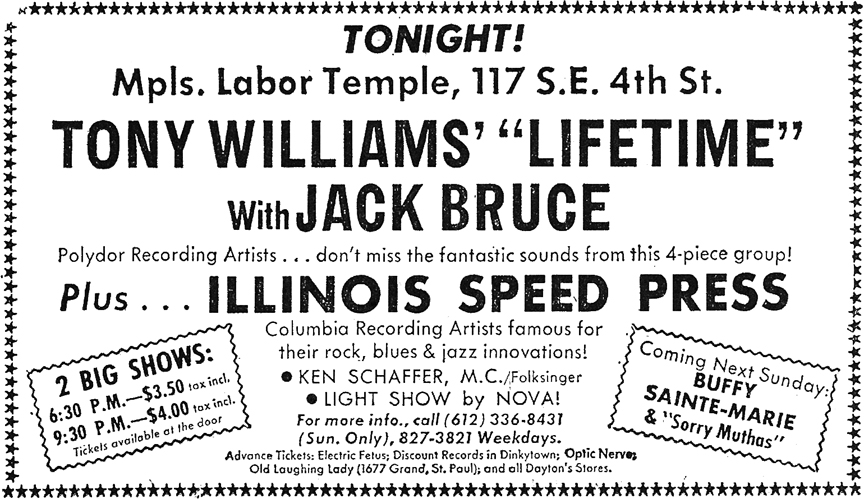
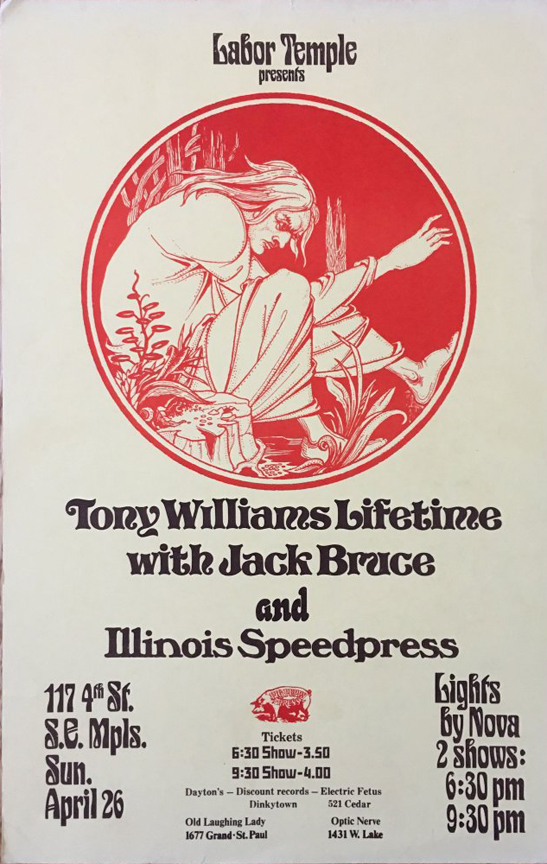
This poster was actually on yellow stock.
David Anthony brought this show, which featured Williams on drums, John McLaughlin on guitar, and Jack Bruce of Cream on bass and vocals. The Jazz-fusion sound didn’t attract concert-goers – the review in the Insider called the show “incredibly bad and sparsely attended.”
The following were planned were cancelled:
BUFFY STAINTE-MARIIE AND THE SORRY MUTHAS – May 3, 1970 – Cancelled. This poster had already been printed and was ready for distribution when the show was cancelled, according to the designer, George Ostroushko.
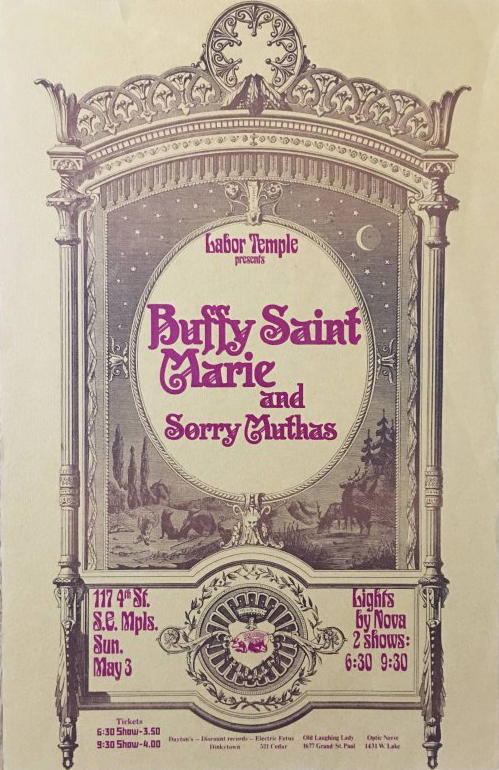
COUNTRY JOE AND THE FISH AND PEPPER FOG – May 10, 1970 – Cancelled
George Ostroushko had designed the poster below for the show and it was at the printers when the show was cancelled so it was never printed. Fortunately, George still had the artwork and finished it in 2017.
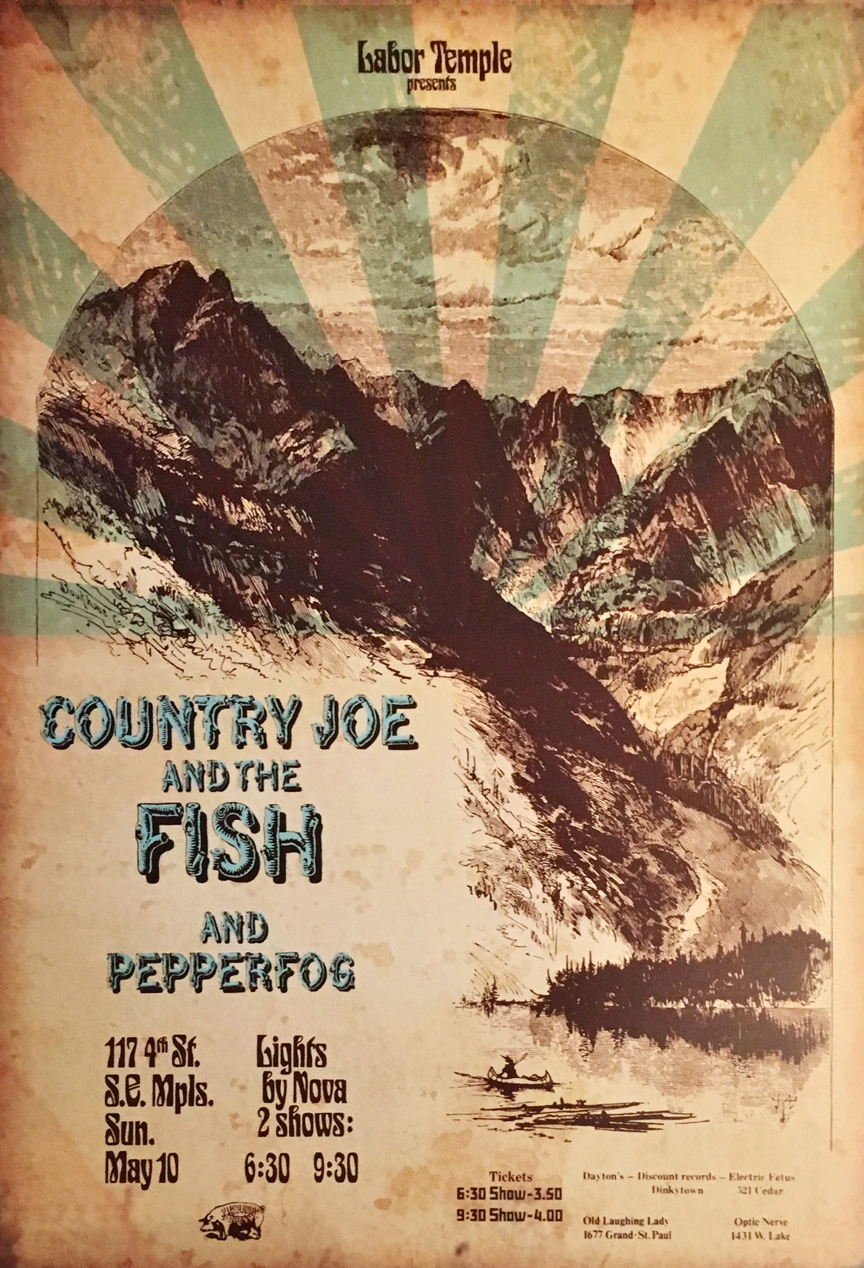
THE BYRDS – May 18, 1970 – Cancelled
BB KING AND THE MOJO BUFORD BLUES BAND – May 31, 1970 – Cancelled
EXIT DAVID ANTHONY
On April 19, 1970, David Anthony announced that the Labor Temple would no longer be offering its regular Sunday evening concerts. Scott Bartell outlined some of the financial problems Anthony was facing:
- His financial backers backed out, since they weren’t getting an adequate return on their money.
- The community was not supporting the venue by coming out to the shows. Anthony had lost $12,000 since January, including $3,200 on the Hammond/Allman Brothers show and $4,500 on the Tony Williams show.
- Audiences were demanding “famous” acts, which were jacking up their prices.
- Colleges were offering acts high fees, which pushed expectations up for other venues.
Other causes cited in other places:
- He had based his ticket prices on a capacity of about 3,000 people, but the fire marshal cut that in half, resulting in a loss of $12,000 from January to May 1970.
- Union members who had offices in the building would try to get in for free.
- He got flak for not using union labor.
This was happening all over the country, and would eventually force the Depot to close as well. In Bartell’s article, Anthony noted that a year ago there were about 250 small houses like the Labor Temple, and now, due to economic pressures, there were less than 75 left.
Minnesota Daily, May 1, 1970
ENTER DANA MARVER
Dana Marver, a 17-year-old from Highland Park, and his mother Gloria, formed Joint Productions and brought in major acts to the Labor Temple in 1970. It became the Fillmore or the Whisky a-go-go of the Midwest, while maintaining a good relationship with the police and taking care of the customers by keeping staff of the YES drug counseling organization on hand.
THE NEW SEASON
An article in the Star said that the Promoter of the coming concerts was the Odyssey Corp.; Dick Shapiro was the agency spokesman. Shapiro said that concerts will be on dates when top groups can ge signed, and which do not conflict with scheduled events of a similar nature at the Guthrie, the Depot, or the Minneapolis Auditorium. (Minneapolis Star, September 11, 1970)
SAVOY BROWN, WHITE LIGHTNIING, AND DAWN – September 13, 1970
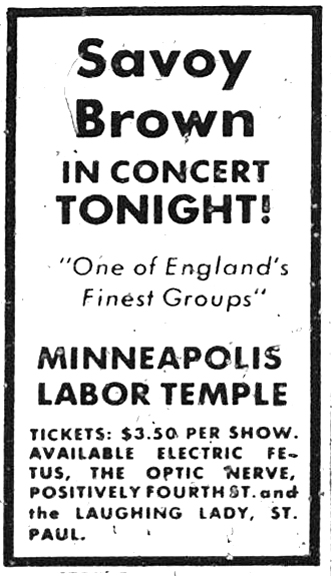
HUNDRED FLOWERS, September 18, 1970
Hundred Flowers had a positive review of Dana Marver’s opening concert, even though Savoy Brown’s equipment was delayed. Opener White Lightning had actually played at the Gathering at the Depot marathon recording event earlier in the day, and played their famous “William Tell Overture” at the Labor Temple show. The other opener was Dawn, a new local group consisting of Ken Shaffer, Dean Carr, “and friend Joyce.” No Tony Orlando. They played some good Neil Young and Donovan.
Finally came Savoy Brown and all their beautiful blue-eyed blues. It was the third trip these Limeys have made to the Labor Temple and they’ve astounded us with their progression each time. Savoy Brown, with some of the very best of the British Blues albums under their belt, brought the house down.
MINNEAPOLIS STAR, September 14, 1970
Dodd Lamberton noted the volume of the groups, opening his review with “Decibel Blues.” Kim Simmonds “kept the sound alive and exciting,” and his 15-minute solo on “Louisiana Blues” was deemed a “masterpiece,” showing not only “good technique but a fine musical ear which so many lead players lack.”
Roger Earl was impressive as he subtly backed up Simmonds’ solo, never getting in the way and avoiding the much-dreaded drum solo that ruins many a concert. Lonesome Dave (according to their manager) on rhythm guitar and Tony Stevens on bass fit in well, except on one number when Stevens totally drowned out Simmonds, who who had switched to piano, and L-Dave, who had a catchy, low-volume lead going. L-Dave also did a creditable job as lead singer.
Of White Lightning, though, he said that they “need new material as they have played basically the same songs they played last night in two recent appearances at the Depot and the Auditorium.”
GYPSY AND PEPPER FOG – September 20, 1970
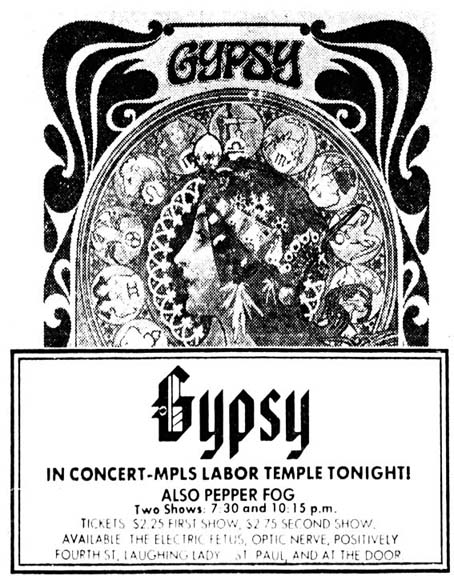
Minneapolis Tribune, September 20, 1970
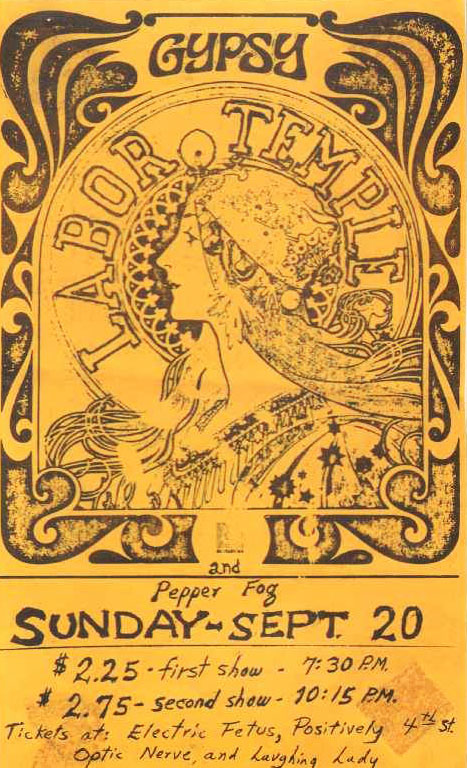
Courtesy David Mueller
The photo below is of Gypsy: Jim Walsh, Rico Rosenbaum, Bill Lordan, Jim Johnson, and Doni Larson. Gypsy was the successor to the Underbeats, a wildly successful ‘sixties band. Drummer Bill Lordan says that the fact that he’s using his mallets in the photo means that they’re playing the song “As Far as you Can See as Much as You Can Feel.” Lordan went on to play for Sly and the Family Stone and Robin Trower.
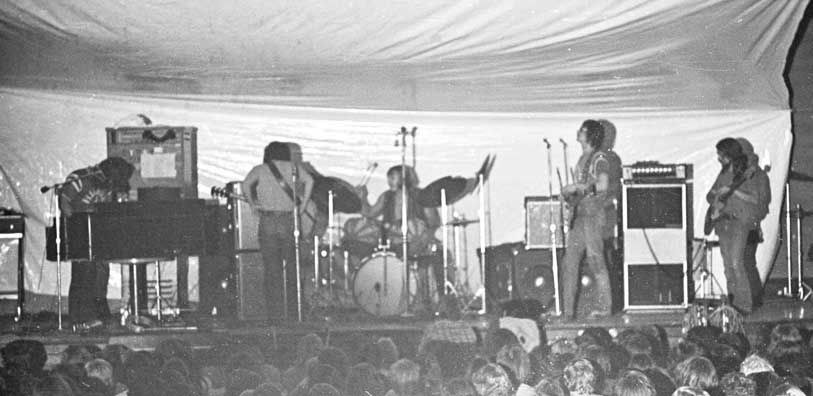
Gypsy – Photo copyright Mike Barich, St. Paul
CONNIE’S INSIDER, October 10 – 17, 1970
This review was written by Kristen Bachler, who wasn’t all that impressed with Gypsy. She said that they could have a unique sound but they were content to play it safe, and gloss over its greatest assets. The band combines two distinctly different musical styles that work well together: basic acidic rock and some unnamed other style, I guess.
She noted that the audience responded very enthusiastically to the group, but she put that down to the fact that Gypsy had members of the Underbeats, one of the biggest bands in Minneapolis in the sixties. She listed the group’s assets, but doubted that they had anything that would distinguish them from other groups trying to make it nationally. They do not challenge the listener, she charged. Oh, here is another reference to conflicting musical styles, “in voice and instrumentation.” In sum, Gypsy had “so much more music to discover within themselves.”
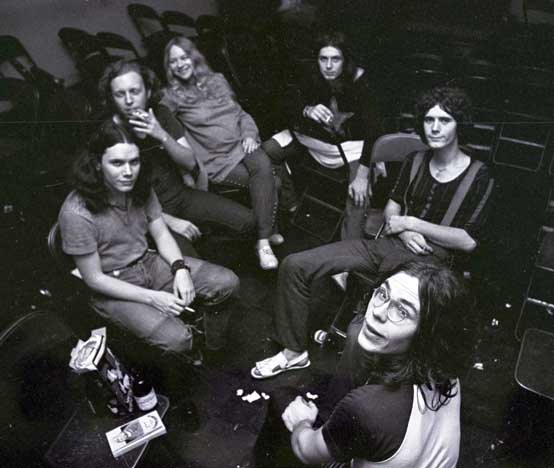
Pepper Fog – photo copyright Mike Barich, St. Paul
JOHNNY WINTER AND BIG ISLAND – September 27, 1970
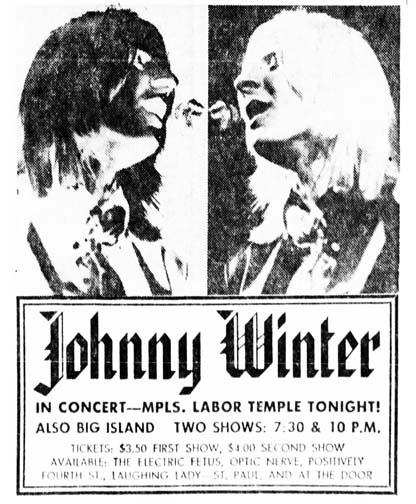
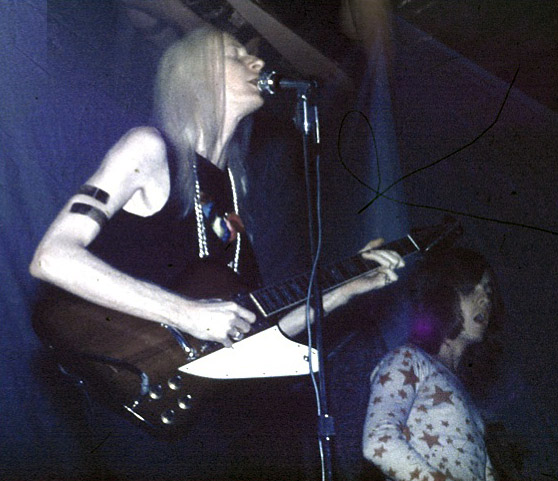
Photo by Lindsay Smith, via Robb Henry
MINNESOTA DAILY (no date)
Jim Gillespie saw the first show, and could hardly contain his disappointment in a performer who had previously turned in excellent shows here in town. After a long delay (their equipment wasn’ t there so they were going to use Big Island’s, but then theirs came, blah blah), Winter came on with a new band that featured Rick Derringer of the McCoys on second guitar.
Did Gillespie hate Derringer! “His stage mannerisms are a vulgar bastardization of moves he has copped from Jimi Hendrix and Peter Townshend” but seemed “cheap and punky with Derrriger because he uses them indiscriminately with no real presence to back them up.”
Both Winter and Derringer’s guitar playing were “mannered and lacking in feeling.”
The review of Winter ended with “Jeez, I don’t even want to write it about it anymore. What makes it even more disgusting is that everyone who saw the second show told me it was really great.” Crap.
Gillespie gave good marks to local group Big Island, though, which would become a house band at the Depot. The opened with “a slick set of original material that went down well with the near capacity crowd.” He noted that they had improved every time he’d seen them, and his only problem was that, like so many groups doing original groups doing original material, the writing lacked variation.
HUNDRED FLOWERS, October 2, 1970
Tom Utne, who apparently saw the second show, was brutal, describing Winter as “tired and bored, insincere in his enthusiasm, and uninspired.” The audience, who had to wait an extra hour outside for the first show to end, was “tired and bored, insincere in its enthusiasm, and uninspired.”
The traditional foot-stomping finger-popping Winter blues was stumbling and awkward for Winter and especially for his sidemen. The rock and roll didn’t rock and the show was outrageously short. The ovation that followed was more an expression of that outrage than appreciation. Plainly, Winter hadn’t fulfilled his contract they wanted their money’s worth. They got the bastard back of course and everyone was beautiful again, but that sticky, stupid situation only served to raise more doubt about that whole scene.
CONNIE’S INSIDER, October 10 – 17, 1969
Kristen Bachler’s review characterized Winter’s concert as more of a
public jam session, with the performers oblivious to the length of the pieces and perhaps intentionally ignorant of the electrical and logistic problems of the evening. The audience was surprisingly quiet as the rought, spontaneous, loud music ruched (sic) over them. They became more overtly enthusiastic when the group broke into an old rock ‘n’ roll tune which began recognizeably, but then was transformed as Wiinter and his people wove their particular musical design into it. The results were exciting and unexpected.
Winter’s style has changed radically in recent months and those who are used to his old sound will be surprised by the “get it on, happy music” he and his group are putting down now.
Big Island got good marks as one of the finest jazz-rock bands in the area. Their complex rhythm and tempo changes created an unpredictable sound.
Dan remembered,
SHA-NA-NA AND THE MYSTICS – October 4, 1970
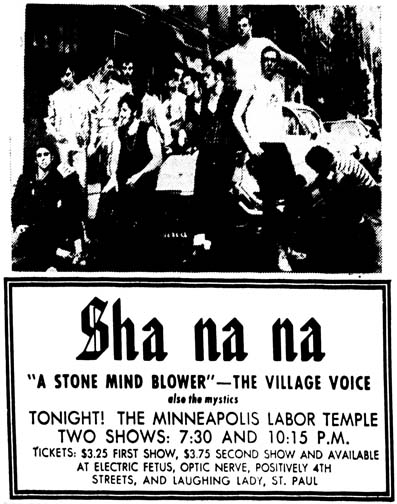
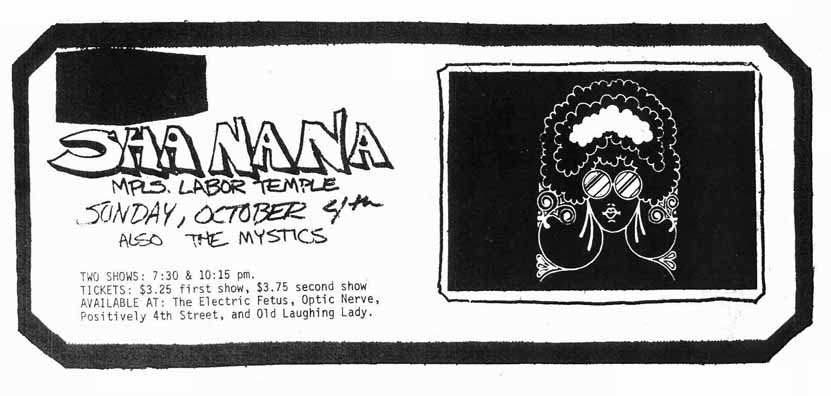
Hundred Flowers
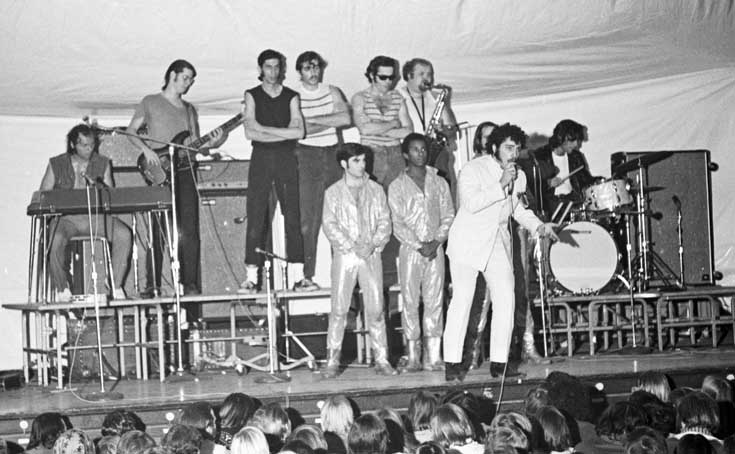
Sha-Na-Na – Photo Copyright Mike Barich, St. Paul
MINNEAPOLIS TRIBUNE, October 5, 1970
Scott Bartell’s review spent a lot of space reviewing the ’50s in general, grateful that we could enjoy the music and not the “other kind of crap that went with life then.” He described the music as “occasionally a little sloppy, always loud, but always a very good reflection of the period and suited perfectly to the group’s approach.”
Although he didn’t name him, his favorite of the group who were “both actors and musicians of estimable quality” was Bowser,
a cadaverously thin cat who slinked on stage in pointed black shoes, white sweat socks, tight black pants that didn’t reach the tops of his sock, a black T-shirt, greasy black hair with sideburns, and a scowl that a pro wrestler would envy. At one point, the group stopped a song long enough for him to spit eloquently at us before singing the last note.
Dana Marver says the guys were playing jazz to warm up and only took on their ’50s personas when they “greased up.”
POCO AND JARREAU – Opened by the Hot Half Dozen – October 11, 1970
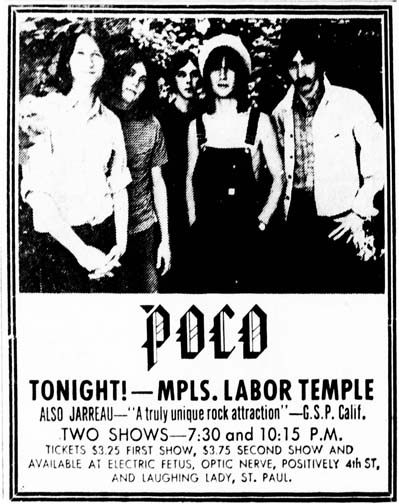
HUNDRED FLOWERS, October 16, 1970
You’ll watch with brotherly pride as they stride onto the stage – so young and so fresh and so vital – and with such warmth and honesty you’ll have to return the affection…hmmm, Poco! Whatever their worth as musicians, you’ll find yourself digging Poco before they play a song.
And once they begin? You bet. They sure have a big start in Richie Furay and Jim Messina, both former members of the heralded and much-missed Buffalo Springfield.
Like the Springfield, Poco’s strength lies even more in their harmonies than in their guitars. Indeed, drummer George Granthuny and bassist Tim Shmidt fit so well with Furay that neither Messina nor Rusty Young sing at all anymore.
The Poco spirit – energetically kind, sweet, humble, and united – doesn’t come at all from the gut but it is so enthusiastically offered and overflowing that they simply lay it at our feet. And, singing pretty-as-a-picture three-part tenor harmonies is as soulful as a country boy can get.
Sunday at the early show that’s how they finished it. After going through a lot of changes in their set, from electric lead to acoustic to dobro, and from country rock to purer country, they finally got it on for the young audience, and in so doing really put psychedelic music into its proper perspective. None of that screaming bullshit. Just good and controlled distortions and loud and euphoric guitar and dobro licks.
It all was so down-home that even the hyper Temple crowd was solidly relaxed when Poco walked off the stage. It took us about 15 seconds before we got sentimental about them and realized that we wanted them back and could get them back.
So the delayed ovation worked and Poco returned for a 20-minute encore. And with everyone on their feet for the first time, the energies were profound. It’s good to see Poco-music accepted so well. Bravo Poco! Bravo Temple!
MINNEAPOLIS TRIBUNE, October 12, 1970
Scott Bartell was disappointed in Poco, and couldn’t really describe why. They played well to a good sized audience.
Yet somehow they just didn’t get anywhere; the songs sounded too much the same. The instrumental breaks weren’t interesting, even the dobro solos on the acoustical numbers they did. Some of the guitar breaks on their electric songs came close to suffering from the acid-rock indigestion (sans feedback) of some lesser groups And most of the electric stuff was far too loud, even painful.
Their encore went on and on until I really didn’t want any more That was what surprised me – they just seemed very empty, not making much more than background music. Maybe just a bad night.
But Bartell deemed Jarreau a “happy discovery,” who did “fantastic percussion and instrument mimicry with his voice. They only did five songs, two original, and they were rather long-winded but they kept me interested most of the time.”
MINNEAPOLIS STAR, October 12, 1970
Dodd Lamberton was pretty frank, saying that Poco “bombed in their first show” and “showed only snatches of talent.” The first four numbers sounded fine, but then “disintegrated into dull, drawn-out numbers that were more hard rock than country-western.”
Lamberton was also a bit put out by the audience, who apparently gave the group a standing ovation for what he deemed a substandard performance.
My advice to the individual listener is this: Listen for yourself. Do not be intimidated into joining the inevitable standing ovation unless you feel it is earned If enough people are discriminating in their applause, Minneapolis will cease to be an “easy mark,” where groups can perform badly and still be received well.
MC5 AND BROWNSVILLE STATION – October 25, 1970
… but the MC5 cancelled two days before. Brownsville Station went on, plus a band from Detroit called Night Train. And/or a band called Mainline, according to Hundred Flowers. This setback caused Marver to have to cancel the return of the Allman Brothers.
ALBERT KING AND THE SORRY MUTHAS – November 1, 1970
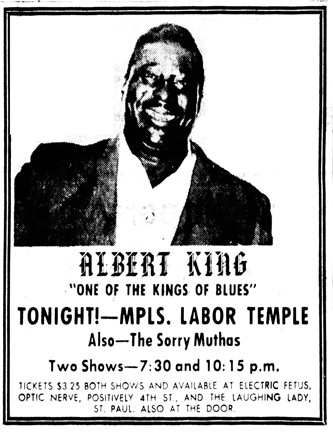
MINNEAPOLIS STAR, November 2, 1970
Jim Gillespie wrote two different reviews; one for the Star and one for the Daily. In the Star he emphasized how large King was and how he dwarfed his five-man backing group, even making his Gibson “Flying V” guitar look like a toy. His rural blues seemed out of whack with his modern R&B backup group. He didn’t sing much, but when he did his voice seemed to lack the power of his records.
As for the opening act,
The Sorry Muthas, a local country-influenced group, opened the show with an all-too-short set of traditional material. They have a good-timey vocal sound and feature a fantastic dobro (unamplified steel guitar) player as lead instrumentalist.
MINNESOTA DAILY, November 6, 1970
In this review, Gillespie noted that King had been booked into the Labor Temple twice before but had cancelled. But, he said, this performance was worth waiting for. Unfortunately the crowd was smallish. He said the band, which was relegated to one side of the stage, was made up of a trumpet, saxophone, bass, organ, and drums. King was on the other side of the stage in a spotlight, and would “occasionally give them dirty looks for missing one of the changes or playing so loudly as to obscure his vocals.”
Gillespie called King’s style
somewhat limited and his guitar riffs at times repetitious but the power and feeling of authenticity he brings to numbers like “Crosscut Saw” and “Born Under a Bad Sign,” is undeniable and makes it quite easy to forget about his shortcomings.
HUNDRED FLOWERS, November 6, 1970
John O’Brien added the interesting detail that the trumpet player only had one arm… As for King,
He couldn’t seem to get through, and he knew it. There was some trouble with the sound equipment: the audience couldn’t hear it, but he could, and it cramped his style. He was fighting the sound system, and sometimes his tired sidemen, trying to get out the blues he was obviously feeling. It wasn’t until about four songs from the end that he finally broke through, when he did a blues called “I Feel Like I’m Drowning on Dry Land.”
O’Brien also mentioned that the Sorry Muthas were booked for a two-month east coast tour.
AMBOY DUKES AND ALICE COOPER – November 8, 1970
This show turned out to the Temple’s last, and it went out with a lot of noise.
HUNDRED FLOWERS, November 13, 1970
The unnamed reviewer didn’t much like this “Post Halloween Freak Out.” Of the Amboy Dukes:
After staggering, stomping, and sliding to and from his amps, [Ted] Nugent freezes as the spotlight and a mike point to his face. The moment to play with our heads is there, everyone hangs in anticipation for Nugent’s next move. His face goes through a series of contortions as he speaks a few tongue tied syllables in between agonizing gasps of breath into the microphone. Nugent finally breaks into a semi-coherent statement about melting into one mind, then begins an impressive feedback mix that took preference over the anti-climax freak-out theatrics.
Whatever saved the performance it wasn’t saved by much, even though the Dukes were called back for an encore, whereby they did a straight rock number that pacified any urges to hear more.
Then it was time for Alice Cooper; at this point it was necessary to explain that Alice was a guy. Alice walked on “gay swishing across stage, giving a limp wristed wave to the audience.” He was described as “bumping and grinding his way across stage in classic drag queen fashion,” but his “gay teasing got old quick.”
The Cooper company ended their performance by going into a sardonic musical sketch complete with devil’s scepter, Alice draped in a sheet, and the drummer queen posing a symbol stand over other member of the band’s heads. Alice had more dramatical trick up her sleeve than the Dukes but it was hard just the same to decide who was the most anti-climax of the two.
Dana Marver remembers being with the bands at the Holiday Inn Central and bumping into Frank Zappa and the Fifth Dimension in all their glory.
ALLMAN BROTHERS – November 15, 1970 – Cancelled
THE END OF THE LABOR TEMPLE
Dana Marver was forced to stop hosting concerts at the Labor Temple at the end of 1970. The reasons were many, according to an article in the November 19, 1970, issue of Hundred Flowers:
- The Labor Temple insisted that all concerts must end at 10 pm.
- A petition was presented to the Mayor’s office complaining about the loud music, but it had only 16 names on it. “One of the signers lives in Excelsior, which puts the whole petition to ridicule.”
- Marver and his booking/publicity agent, Dick Shapiro, were at odds; “Shapiro has made obvious plays to take over Sunday nights, and has discouraged Dana from continuing.”
- There was a “lack of community interest and support.”
- “The Labor Temple Board has had a hard time relating to the idea of a 17 year old promoting concerts.”
And so ended the musical career of the mythical Labor Temple. The building was torn down – the demolition permit was issued on December 30, 1974, and it was demolished in 1975.
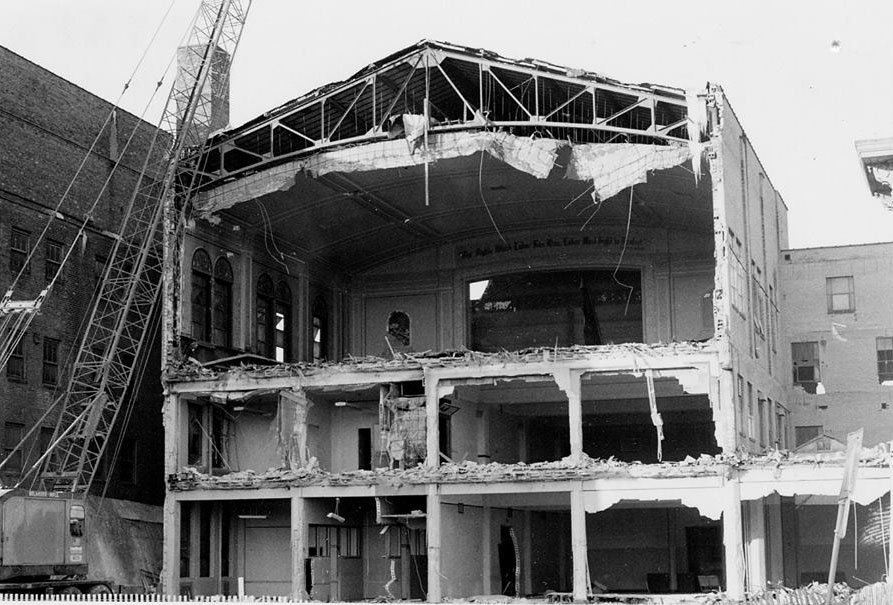
1975 Photo Courtesy Robert Borchert
The property was sold to the owner of Aveda by Campus Church Assoc. on February 1, 1986, for $107,476 and is now the Aveda parking lot.
And yet … so many people still think that the Aveda building is the former Labor Temple – we even got a tour of it, by someone who told us that Janis Joplin performed right where we stood. Oh dear.
Save
Save
Save
Save
Save
Save
Save
Save
Save
Save
Save
Save
Save
Save
Save
Save
Save
Save
Save
Save
Save
Save
Save
Save
Save
Save
Save
Minneapolis – early Mike Waggoner and the Bops venue
Much of the information and photos on this page come from the book Looking Back at White Bear Lake-A Pictorial History of the White Bear Lake Area by Cynthia Vadnais. Additional assistance was provided by Sara Markoe Hanson at the White Bear Lake Area Historical Society.
The Lake Shore Inn was located in Cottage Park at the corner of what is today Circle Drive and Cottage Park Road, near Lion’s Park.
COTTAGE PARK CLUBHOUSE
The Cottage Park Association built the Cottage Park Clubhouse in 1882 to serve the people who lived in the surrounding cottages, which didn’t have kitchens. By mid-1887, most of the cottage dwellers had built kitchens, so the Clubhouse had no purpose, and the interior was sold off.
WHITE BEAR HOSPITAL AND SANITORIUM
After standing vacant for several years, Thomas C. Fulton and J.E. Ramley bought it and transformed it into a hospital and sanitorium (presumably for tuberculosis). A 1910 ad said that the capacity was 30 patients. On February 23, 1912, it became the Minnesota Eye, Ear, Nose and Throat Hospital. Next it became the Lake Shore Sanitarium from 1914 to 1918.
LAKE SHORE INN
In around 1920, Charles Bennett took over the vacant property and made the large building into an inn with 30 rooms and a large dining room that seated 200. The restaurant was known for its chicken dinners.
A four-line classified-type advertisement can be found in the Minneapolis Tribune on October 10, 1920.
Note that the ad below mentions dancing to Ed Smith’s Society Syncopators. In a caveat I’ve never seen before, it cost 25 cents to dance, but nothing to listen.
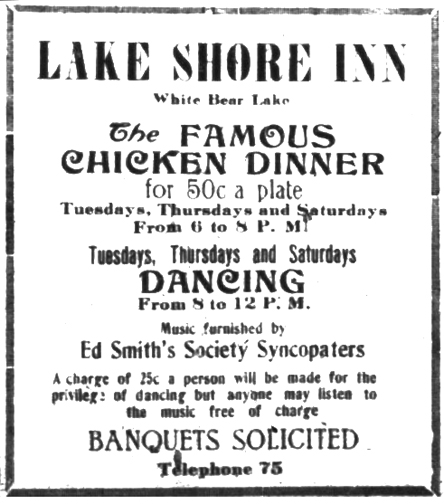
1922 ad from Looking Back at White Bear Lake-A Pictorial History of the White Bear Lake Area by Cynthia Vadnais
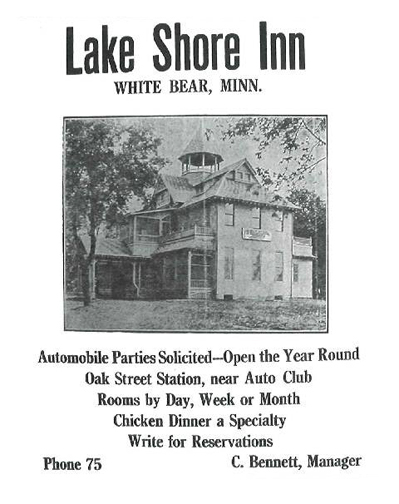
White Bear Press
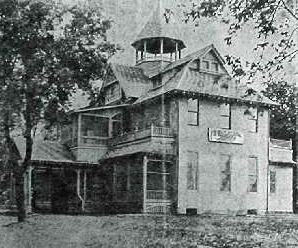
Close-up of photo above
By 1932, Charles Bennett’s son Carl and his wife were running the hotel.
The contents of the Lake Shore Inn were auctioned off on June 25, 1934.
COLLETTS’ LAKE SHORE INN
The Lake Shore Inn was taken over by Mr. and Mrs. W.B. Collett in 1935, and they renamed it after themselves. They ran it for a few years, and then, once again, the building stood empty. An ad from August 24, 1935, did offer music.
Again called the Lake Shore Inn, now with Mrs. I. O’Leary as Proprietor, the opening in September 1941 was advertised as a “large hotel with over 20 rooms.” By 1942, however, an ad described “apartments and meals,” “rooms by Day, Week or Month,” which appears to be more like an SRO apartment building or a boarding house. Mrs. O’Leary also offered dinner party service.
Attempts have been made to use the building as a nursing home or an apartment building, but zoning laws killed both plans, and most of the building was demolished in 1946. The private residence that stands in its place is said to incorporate a structure that resembles the old Cottage Park Clubhouse.
Much of the information for this page comes from the October 2021 Newsletter of the Westonka Historical Society, written by Elizabeth Vandam.
THE HOLLOW
Only a short stretch long, the Hollow, as the locals still call it, was a section of Sunset Drive along the shore of West Arm on Lake Minnetonka in Spring Park. Incredibly, there were two hugely popular jazz venues on each side of this small stretch of road from about the 1940s to about 1970: The Downbeat was on the north side, and the Lakeview was on the south. Patrons came from all over the area (at the time a 25 minute drive from Downtown Minneapolis) to hear some of the biggest and best purveyors of jazz in the world. Some even came by boat!
THE LAKEVIEW INN
This page is about the Lakeview. There is a separate page about the Downbeat.
The name of the Lakeview underwent slight changes over the years. Never in any ad or article have I found a street address for this venue!
THE ATHLETIC CLUB
The building is obviously quite old, and an early use as a music venue was the Athletic Club Restaurant, owned by Carl and Ella Wicklund. The ad below shows that Bob Burak’s Orchestra provided music for dancing at the Athletic Club.
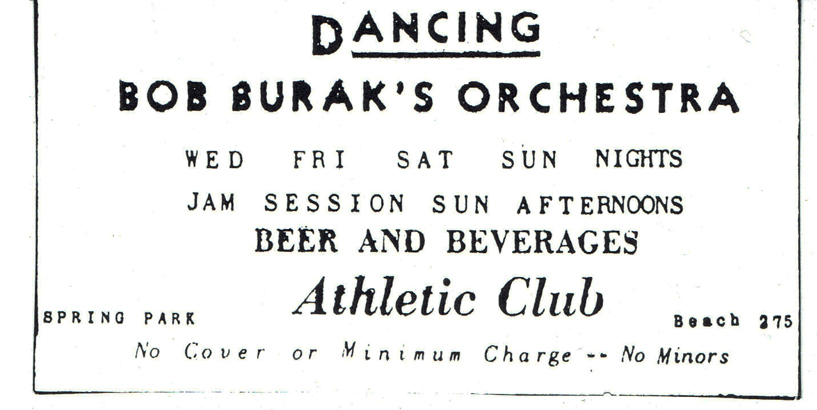
Ad courtesy Westonka Historical Society
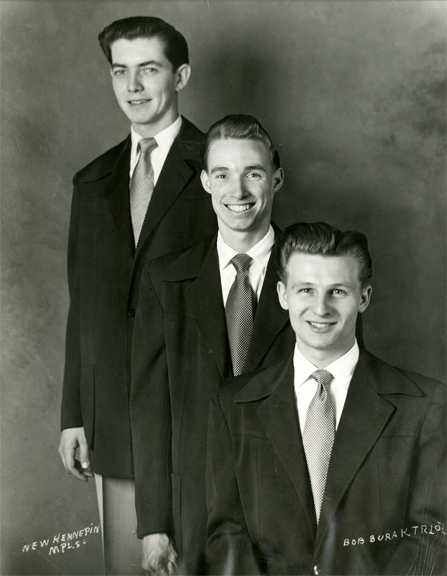
Bob Burak Trio. Photo from Burak Family Archives, courtesy Westonka Historical Society
At the time the photo below was taken (date unknown), the trio had four members: Bob on drums and saxophone, Wally Fuller on piano, Morrie Wasserman on trumpet, and Jerry Pearson on clarinet and saxophone. We can see the word “Club” on the sign outside, which means it’s probably still the Athletic Club.
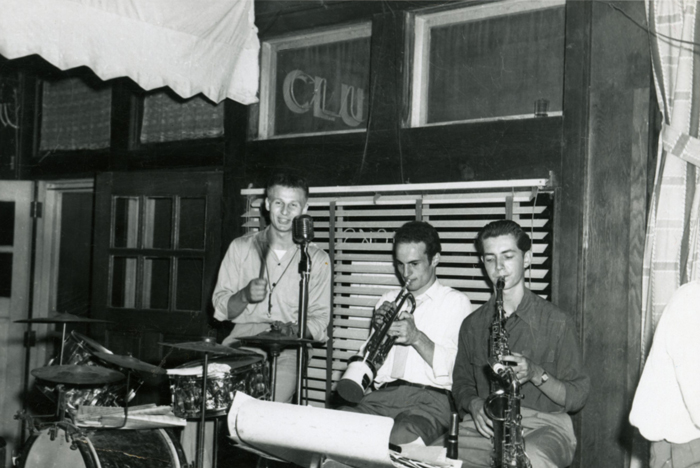
Bob Burak Trio. Photo from Burak Family Archives, courtesy Westonka Historical Society
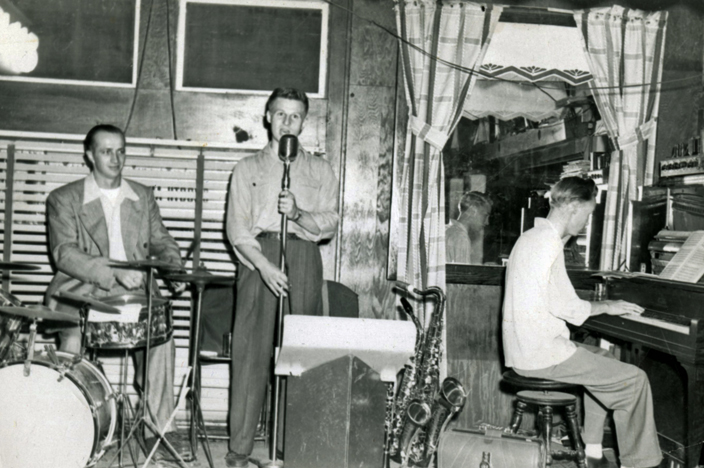
Bob Burak singing with his Trio. Photo courtesy Westonka Historical Society, Burak Family Archives.
BOB BURAK
The Lakeview Inn was born when the Wicklunds sold the Athletic Club Restaurant in 1949. The new owners were Bob and Eileen Burak. Bruno Milton (Bob) Burak was the son of a Polish dairy farmer who grew up in Willow River, Minnesota and moved to Minneapolis when he was 17. He trained to become a professional barber, and started playing music. After serving in World War II, he returned to Minnesota and worked as a musician and a barber to make ends meet. He dreamed of owning his own place to play music and offer good food.
Up in Crosby, Minnesota, Eileen Johnson was an 18-year-old telephone operator in 1947. Family lore is that Bob, then 23, was in the area one weekend to provide the musical entertainment at a dance. While attempting to place a call with Eileen’s assistance, the two chatted. Quietly, Eileen remained on the line after Bob thought that they had ended their conversation, and she found out where he would be playing that night. She made it to the show, and a year later they were married.
THE LAKEVIEW INN
The Lakeview Inn opened on May 7, 1949. Bob’s trio provided the entertainment. It may have taken time to catch on, as a 1951 ad refers to the reopening of the Athletic Club in Spring Park.
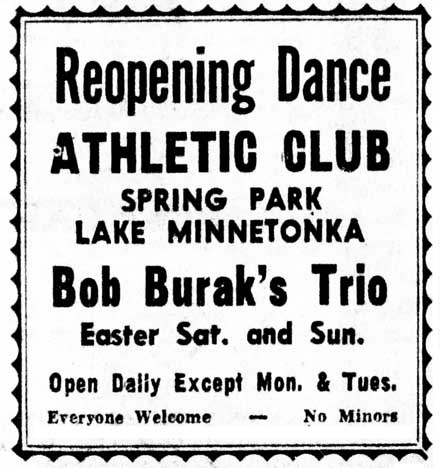
Minneapolis Star, March 23, 1951
LAKEVIEW DANCE INN
As is the usual case, the first evidence we find of the place is in the classified section, advertising for waitresses. Ten times, between June 3, 1955, and May 22, 1956, the club is referred to as the Lakeview Dance Inn.
LAKEVIEW INN
The first (and apparently only) ad in the Minneapolis papers made it clear that the name was actually the Lakeview Inn.
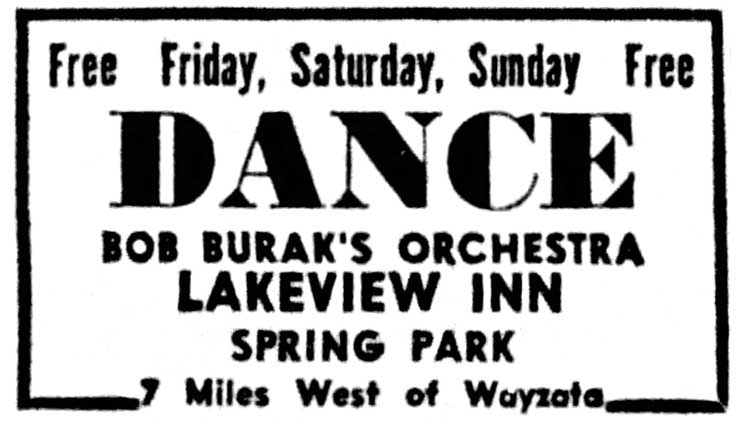
Minneapolis Star, June 4, 1955
DICK AND DON MAW
The Maw brothers moved to Minneapolis from Buffalo, New York, in 1944 when they were 10 and 12 years old. They formed a small combo and performed at various high school and college dances in the area while attending West High. One article said that Dick Maw was with the band for 20 years before moving to Lutsen in 1967, which would mean that they started their orchestra in 1947.
In May 1954 they founded the Twin Cities Jazz Society, which by August 1955 was reported to have several hundred members. In addition to performing in their own band, they became promoters; one of their first shows presented was a Louis Armstrong concert at the Lyceum Theater on November 21, 1954. On February 20, 1955, they brought Dave Brubeck to the Lyceum Theater as well.
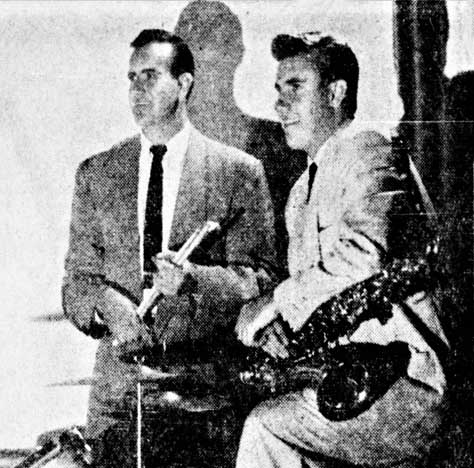
Dick and Don Maw. Photo from Minneapolis Tribune, August 21, 1955
By 1957 they were promoting jazz performers in Minneapolis and other cities, distributing a couple of dozen jazz labels, producing acts for Zephyr Records, and playing in and managing orchestras with 4 to 14 players. (Minneapolis Star, June 5, 1957)
1957
THE NEW LAKEVIEW
In 1957 the Lakeview Inn was renamed the New Lakeview, owned/leased by Dick and Don Maw, with help from their father, Ralph Maw.
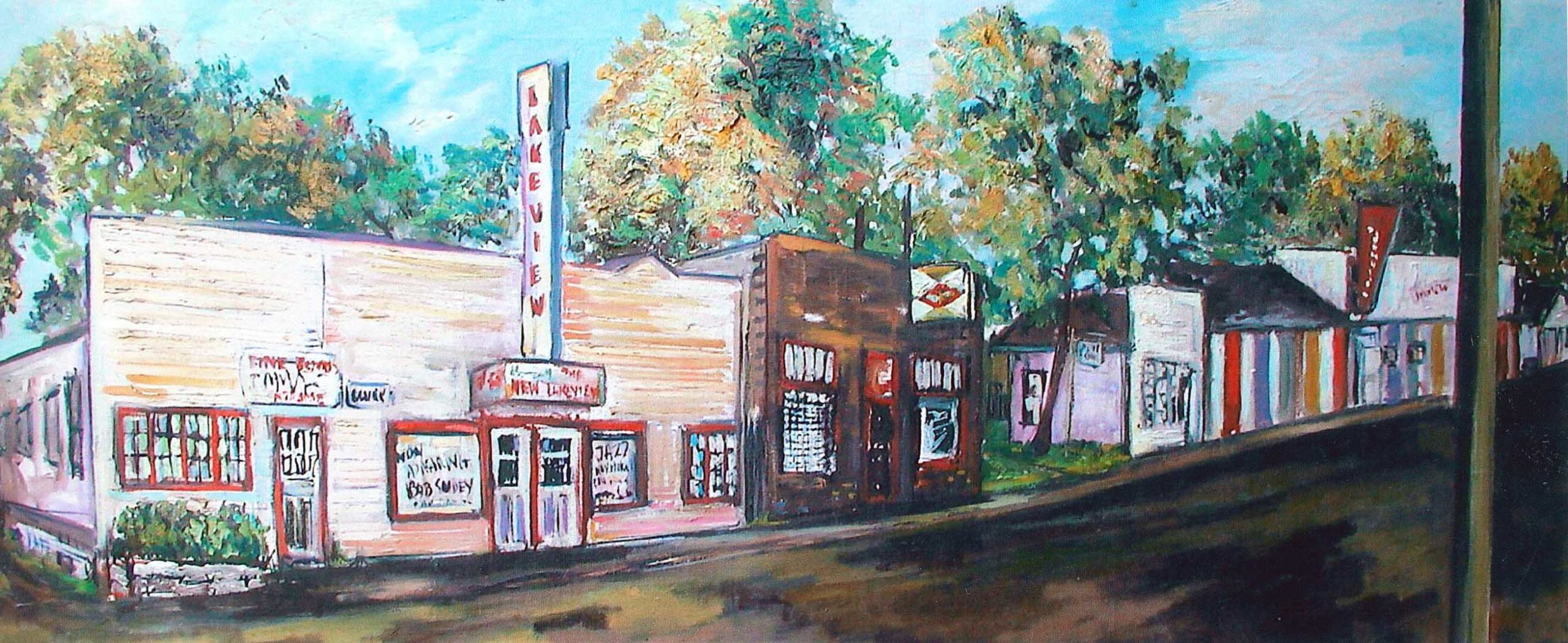
Painting of the New Lakeview by Dick Maw, courtesy of the Westonka Historical Society
It appears that at first, entertainment was provided by the Maw Brothers’ band.
On June 28, 1957, Will Jones reported:
Jazz is so successful on Lake Minnetonka that Dick and Don Maw say they will have their band in action five nights a week, instead of just three at their New Lakeview club at Spring Park [Wednesday through Sunday]. They also plan to ad water-ski shows at 2:30 pm Saturday and Sunday afternoons…
Unfortunately, the town council of Spring Park put the kibosh on the five-nights-a-week plan, refusing to grant them a dance license for Wednesday and Thursday nights. They did open on Thursdays with a listening-only trio. (Tribune, August 15, 1957)
Combined with the competing Downbeat Club, Spring Park was jumping on Summer nights in 1957, reported Will Jones. Cars, boats, even seaplanes jammed the little town. It took two policemen to handle traffic. (Tribune, July 2, 1957)
The first big-time band was book for October 15 through 27, extended through October 30, 1957. This was jazz trumpet artist Chet Baker.
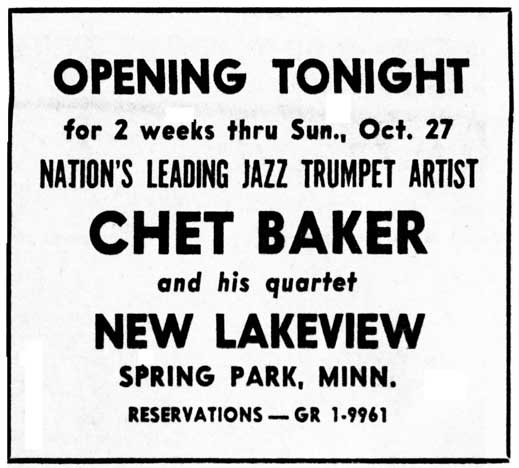
Minneapolis Star, October 15, 1957
On November 15 and 16, 1957, the club included a different kind of jazz when it welcomed Bob Scobey’s nine piece Dixieland band for the first time. The outfit include banjo player Clancy Hayes, two trombones, and a bass tuba.
(Please note that I will not be posting most other ads because they are not very interesting.)
Dixieland continued with the Harry Blons band in a series of Sunday night sessions starting at the end of November 1957, with guest soloists and Leigh Kamman as emcee. Name modern jazz groups were off the table until March – over the winter the entertainers would be the Dick Maw Trio, and something called “HiFi Jazz Sessions, with commentary, during intermissions.” Don’t know if that meant they were playing records or not.
1958
As promised, the club reopened on March 28, 1958, with the Phil Ruedy Trio, “Direct from Miami Beach.” Will Jones reported all the news in his column that day:
The place now boasts a glass roof over the dance floor (“dancing over the stars”), a new food policy (full dinner menu and chuck-wagon lunches), and a line-up of both modern and Dixieland jazz artist. Pianist Phil Ruedy heads a trio that will play six nights a week and Sunday afternoons through the summer. Local Dixieland groups continue their Sunday sessions. Bob Scobey’s San Francisco Dixieland band comes in next Tuesday for a three-night stay.
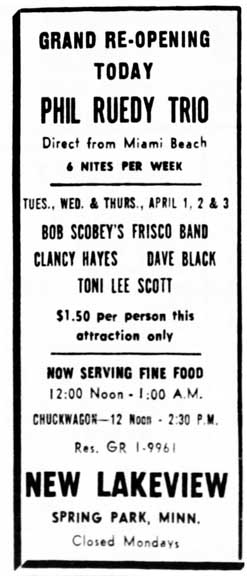
Minneapolis Star, March 28, 1958
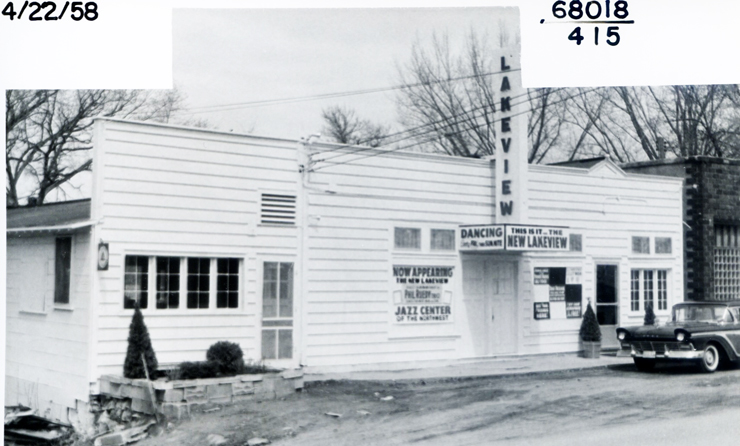
Photo from the Spring Park Assessor’s Office, courtesy Westonka Historical Society
Subsequent bookings in the spring of 1958 included:
The Herb Pilhofer Octet, for a session of modern jazz on April 27
Bob Scobey’s Frisco Band return engagement, May 3 and 4
John Doling Quartet, house band starting May 7
The Kai Winding septet, made up of four trombones and a rhythm section, on May 22. The group “grabbed for a fast booking between an engagement at the Blue Note in Chicago and a one-nighter in Superior, Wisconsin.” (Will Jones, May 22, 1958)
Chet Baker came in with a Chicago group for the Memorial Day weekend, stayed on through June 12.
Bob Scobey’s Dixieland band returned, June 13 through 15.
HERBIE MANN
Jazz Flutist Herbie Mann played a stand from July 1 through 20, 1958. He was backed by a local group made up of Marv Dahlgren, symphony tympanist, on vibes and drums; Skip Christman on piano; and Lynn Thompson on bass. Flutist Dave Kerr joined him on Sunday nights for some flute duets during his stay.
In an interview by Mercer Cross in the Minneapolis Tribune, Mann, 28, said that there was “definitely an audience for jazz in Minneapolis,” and “I’d rather play here than any other city in the country. The response has been wonderful, both personally and professionally.” He called our city “a virgin area as far as jazz goes. It’s off the beaten track that the jazz groups make. Either the money has to be good or there has to the another reason for coming here.” His reason was to vacation – he lived in New York with his wife Ruth, who worked as a secretary.
In the article his drummer was named as Tom D’Andrea. It also said that in addition to the flute, he also played tenor saxophone. He was given credit for the first, in 1953, to give the flute widespread popularity in modern jazz. He was in the process of forming and octet, and one of the reed men would be Dave Karr.
Kai Winding was back from July 20 through 27, 1958.
Pianist Oscar Peterson and his trio appeared on July 29 through August 2, 1958. His sidemen were Herb Ellis on guitar, Ray Brown on bass.
Dave Wesley’s Tomcats entertained from August 7 to 24, 1958. This outfit originated at St. Thomas College.
DAVE BRUBECK
The club’s new policy of big names only started with a bang, featuring jazz superstar Dave Brubeck smashing records in a 13-night stay starting on August 26, 1958. Paul Desmond appeared with him on alto sax, Gene Wright on bass, and Joe Morello on drums.
In a review by Mercer Cross, Brubeck was described as “a picture of animated concentration” as he opened with “St. Louis Blues.” Other pieces included “These Foolish Things” and “Watusi Drums,” the latter written by Brubeck.
The quartet played everything as if it had never been played before. That’s because they never play anything the same way twice. Brubeck, a jazz musician who takes his profession extremely seriously, explained it this way: “Playing jazz is something that is a night-to-night experience. When you can no longer communicate emotion, which is the duty of any artist, you might as well quit.” (Tribune, August 27, 1958)
Bob Murphy of the Tribune reported that Brubeck was packing them in.
Brubeck’s draw probably is due to the fact that he is one musician as entertaining visually as musically. Althletic and driving, his fingerwork is something to see, and in guts, imagination and technique he’s not to be topped. (August 31, 1958)
Cedric Adams weighed in as well:
I watched the jazz addicts of the Dave Brubeck quartet at a matinee over the weekend. These Brubeck fans go into a regular trance and are suddenly and regular brought into an explosion of applause during each solo number. If you want to give an order to a waitress while the quartet’s playing, you’d better do it in a soft whisper or you’ll get a loud “sssshhhhhh” from surrounding patrons….
The group has had standing room only since its opening at Lakeview last week. If you want to see fans completely entranced, drop out during this engagement. (Minneapolis Star, September 2, 1958)
Buddy Rich and his quintet opened on September 9 through 14, 1958.
The Chico Hamilton quintet opened September 19, 1958 for ten days.
Ernestine Anderson opened on October 5, 1958, for one week. Cedric Adams of the Star reported that her premiere was important enough to bring Jack Tracy, director of jazz for Mercury records, up for the opening. She had just recorded her first album, “Hot Cargo,” and been written about in Time magazine that August.
George Shearing appeared from October 13 through 19, 1958.
Bobby Hackett appeared from October 20 through 26, 1958. Hackett was a trumpet player.
COUNT BASIE
Count Basie was signed for October 27 and 28, doing two shows per night. Special prices went into effect for those shows: $5 per couple per show, or $10 for the evening.
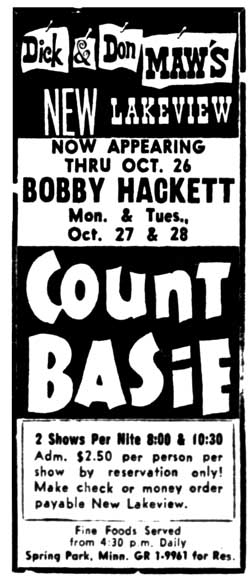
Minneapolis Star, October 20, 1958
DIZZY GILLESPIE
Dizzy Gillespie, “of the bop talk and the up-turned trumpet,” as Will Jones described him, opened for a week on November 24, 1958. The final Sunday he did a teenage matinee and evening show.
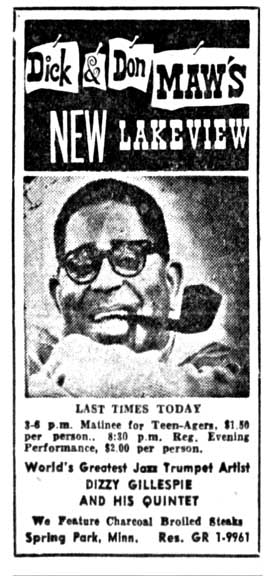
Minneapolis Tribune, November 30, 1958
Plans for the winter of 1958 called for the Herb Pilhofer trio on weekends. Jones also reported that the Maw Brothers were considering booking some name comedy performers to appear along with jazz groups during the winter. The papers were eerily silent.
1959
Two things happened in March 1959, and one wonders if one had to do with the other. First, Dick and Don Maw’s father, Ralph W. Maw, died on March 7, 1959, at the age of 56. In his obituary he was identified as the former owner of the New Lakeview Club. He was also described as the former Minneapolis film distributor for Metro Goldwyn Mayer. He had retired from MGM in 1957 and joined his sons in developing the New Lakewood.
The other thing that happened, and we don’t know timing, was that, as Will Jones reported on March 29, 1959,
Operators Dick and Don Maw have departed the place, and owner Bob Burak has repossessed it. He probably will go in for jazz on weekends this season, he said, but big names aren’t in the picture so far. He has booked the Colman Hechter jazz quartet for tonight.
What Jones may have meant by “repossessed” is anyone’s guess; either the Maws were buying the building and stopped making payments, or were renting and stopped paying rent. Either way, the New Lakeview as it was in its glory years, was gone.
LAKEVIEW INN
On May 8, 1959, the first classified ad appeared for a waitress for the reconstituted Lakeview Inn, again owned by Bob Burak.
On May 15, 1959, Will Jones reported that:
Dentley Haugesag, formerly with the Billy May and RayMcKinley orchestras, has organized a jazz group known as the Dent-Lee quartet. They will open Sunday night at the [still calling it the New Lakeview]. The Bob Sors Sextette is the Saturday night attraction at that spot. Beginning today, the Lakeview is reopening its kitchen.
That seems to be it for 1959.
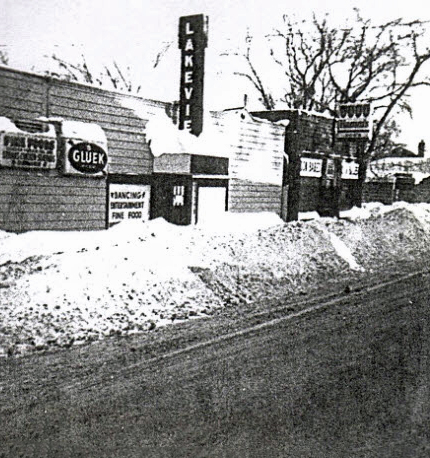
Undated photo of the Lakeville, courtesy Stan Straley
1960
A year later the classified ads in the spring promised that the waitresses would have fun, and entertainment at the night club was furnished by the Bob Burak Combo.
In August 1960 the Bob Scoby Dixieland band returned for a short stint. Will Jones reported,
Bob Burak is busy meanwhile with plans for the nights following Scobey’s departure. He plans to install Thursday talent night sessions and a piano bar, and to become active as a booker of talent. (Tribune, August 10, 1960)
1962 – 1962
There was only one classified ad in 1961, none in 1962.
1963
The club reopened in March 1963, featuring Burak’s combo on Saturdays, and Jimmy Wells, a Country artist, on Sundays.
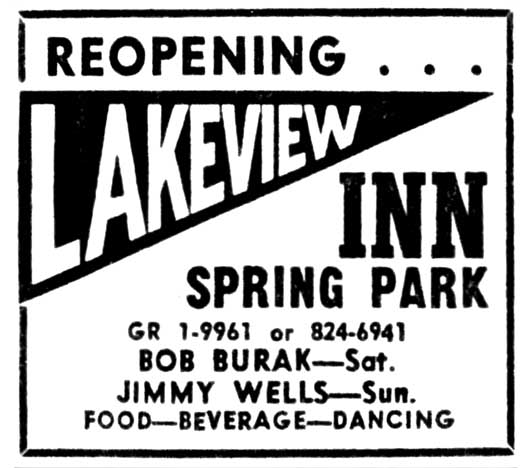
Minneapolis Star, March 21, 1963
This makes one wonder what kind of music Bob’s Combo was playing!
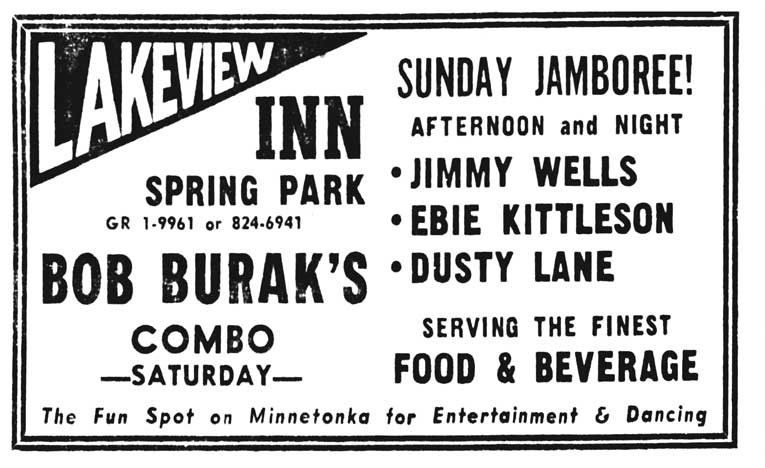
Minneapolis Star, March 28, 1963
The Dakota Roundup had been a fixture at the Flame Cafe on Nicollet Ave.
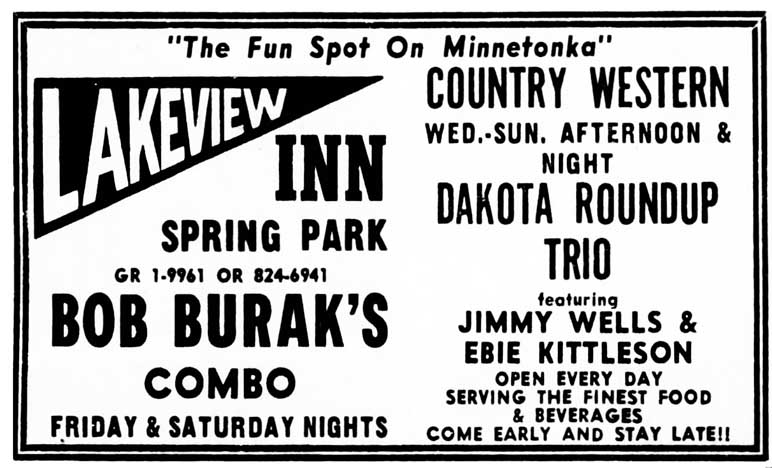
Minneapolis Star, April 1, 1963
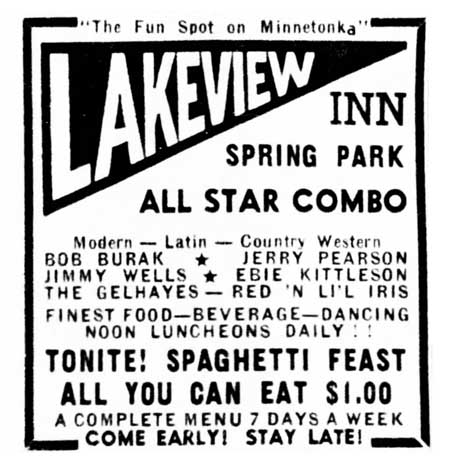
Minneapolis Tribune, June 26, 1963
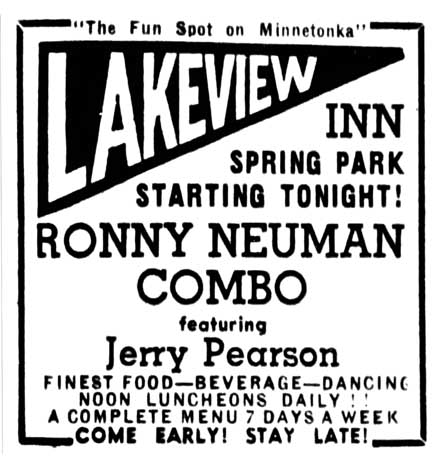
Minneapolis Tribune, July 5, 1963
And then…. nothing.
1964
There are no hits for the Lakeview or for Burak in 1964.
1965
The Minneapolis papers don’t tell the tale, but apparently the Lakeview Inn was hoppin’ in the summer of ’65. Things must have gotten out of control – in August 1965, Bob printed a plea in the classifieds for a manager/partner, listing the assets of the “Nite Club” and ominously offering to sell them off separately. That last part was omitted in later ads, which ran from August 5 to August 15, 1965.
Here’s Will Jones, writing about that crazy summer in his column on November 16, 1965:
Out at Spring Park, where the Lakeview had the rock scene going so frantically all summer they used to lock the doors at 11:00 of a Saturday night, things have slowed down a little. But Bob Burak swears he’s not going to let them come to a dead halt. He’s open three nights a week, Friday through Sunday, and the house band is there Friday and Saturday nights.
This ad also shows up in November 1965. Apparently Bobby Burak was Bob’s 14-year-old son.
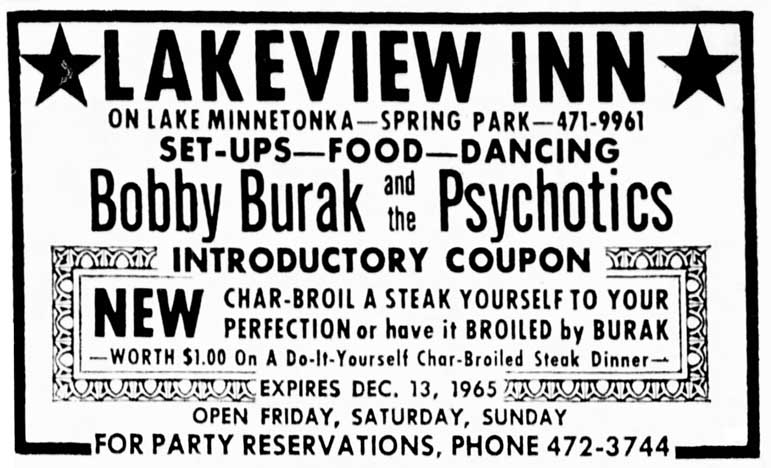
Minneapolis Star, November 25, 1965
The Lakeview became a year round venue that welcomed teens as a safe hangout with a juke box, food and soft drinks, pool, and foosball. Many local teens were employed at the Lakeview as well.
Paul E. Taylor posted the wonderful photo below on Facebook! You can see the Lakeview, then a dive bar called Don & Babe’s. Hidden by trees is the old Spring Park City Hall, and then the Downbeat.
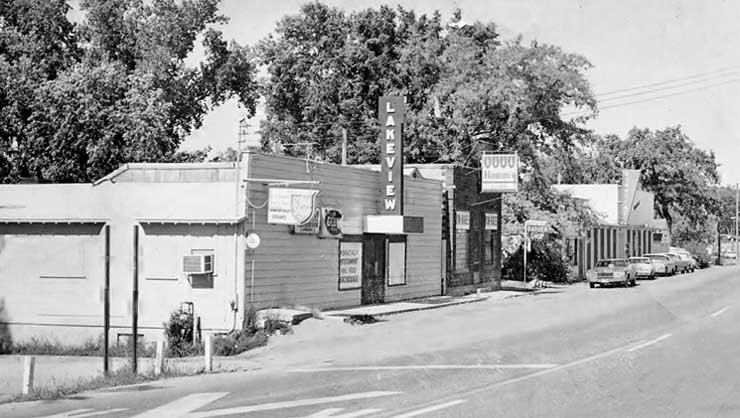
The Lakeview – photo courtesy Paul E. Taylor
By August 1966 Bob was advertising for a manager/partner again.
Will Jones wrote about Spring Park in his column in the Tribune on June 13, 1967. Most of it was about the Downbeat, but he did mention that the Lakeview featured a small rock band and attracted a younger clientele. And then he went into his usual girlwatching spiel that wouldn’t pass muster today…
A December 1967 in the Minnetonka Herald showed the same weekend schedule and Bob Burak’s new Combo.
But in April 1969, Bob Burak was again trying to sell all of his holdings on the lake.
In 1970 and 1973, ads were placed trying to find musicians to play at the club.
And below is the last ad I found for the Lakeview Inn.
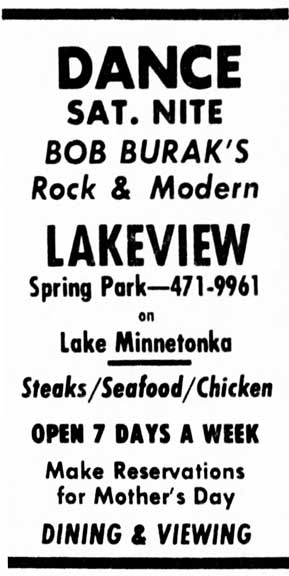
Minneapolis Tribune, May 12, 1973
The last classified ad for a waitress was placed on June 20, 1973, and the place still belonged to Burak.
In 1968 Bob Burak started selling real estate in the Lake Minnetonka area, with consistent ads until July 4, 1979. He died in 1990 at the age of 66.
The Lakeview is gone now, as is the Hollow – now a part of Rockvam’s Boat Yard, a marina which had been establishing itself since the earlier years of the music scene.

Please see the New Lakeview.
Lamb’s Supper Club, St. Paul, went from country/western to rock in 1972. Still there 1974.
The Lamplighter Lounge is located at 160 W. Larpenteur Ave. at Rice Street in St. Paul. It is located in a small strip mall.
Its original owner was Gary Landreville, and I’m told that it was a neighborhood, middle-class bar, with a sign above the door that said “Pink Champagne on Ice.” Guys stopped there after work, and sat around a 15-ft., oval bar. There was a small dance floor and a juke box. My correspondent, who lived in the neighborhood, says it was well kept, clean, and there were no problems or fights.
In 1980, a folk-rock singer named J.D. Elias performed
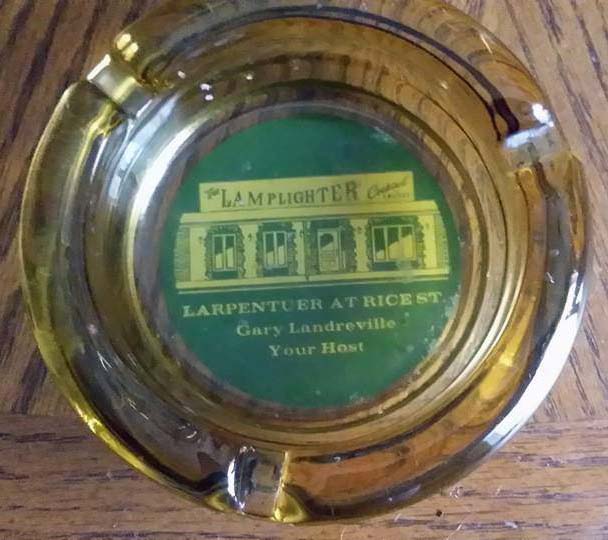
Courtesy Mark Youngblood
Then Gary sold it, and it became a topless place. A space that had been a barber shop and then a pizza place became a glassed-in space where the girls do their show. They are totally nude, but the reviews say the glass gets kind of smeared…

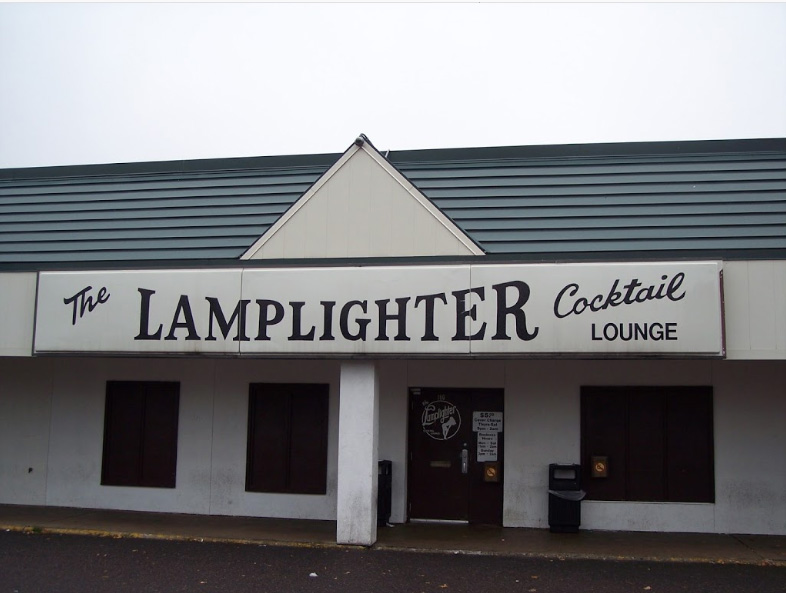
Save
Reilly’s Lake, Eden Prairie, 1935. Saturday and Sunday Nights – Good Music
The Launching Pad was located at 2375 NE Highway 10, north of 35W. Although it was often described as being in New Brighton, it was, in fact, in Mounds View.
This first ad below from 1967 describes it in proximity to an arms plant, perhaps explaining its name?
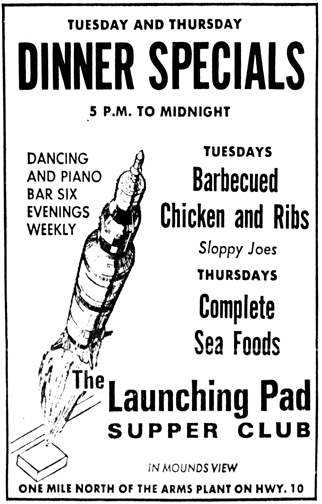
July 9, 1967
From its opening in July 1967 to July 1969, ads styled it as a supper club, with “dancing nightly in the piano bar.”
From the end of 1969 to September 1970, Dee Hilde and the McGuire Brothers were the house band.
Somewhere it says that in 1973 it went from all country to half country, half rock, but it looks like by November 1973 it was all country.
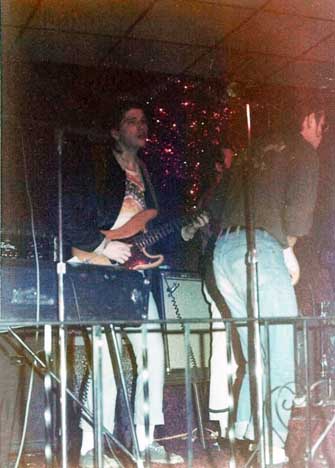
American Grease, December 27, 1975. Photo courtesy Peter Kearney
In 1976, Sherwin Linton and the Cotton Kings graced the Launching Pad stage.
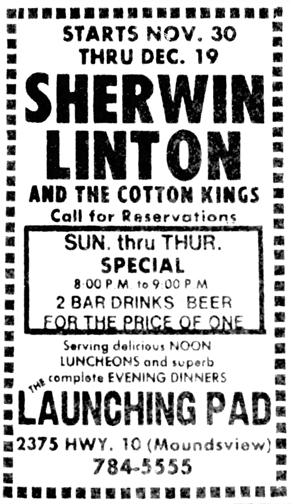
Sherwin says:
I played the Launching Pad several times in 75/76/77. I have a pretty funny story of a fight that broke out on the dance floor and came over the fence and onto the stage as we were closing a show and I was singing Neil Diamond’s “Brother Love’s Traveling Salvation Show.” Blood all over a $2,000 Rhinestone custom-tailored stage suit I was wearing. The owner, Al Hardinger, offered to take it to the best cleaner in town and have it cleaned and he did. Some of the stains did not come out but with the colors of the fabric you could not tell.
The layout of the place was not ideal for a show band with the narrow stage back in the corner and dance floor and the bar between it and the dining and cocktail tables. Consumption of alcohol was high. With today’s laws not many would have made it 100 yards up Hi Way 10 without a DWI.
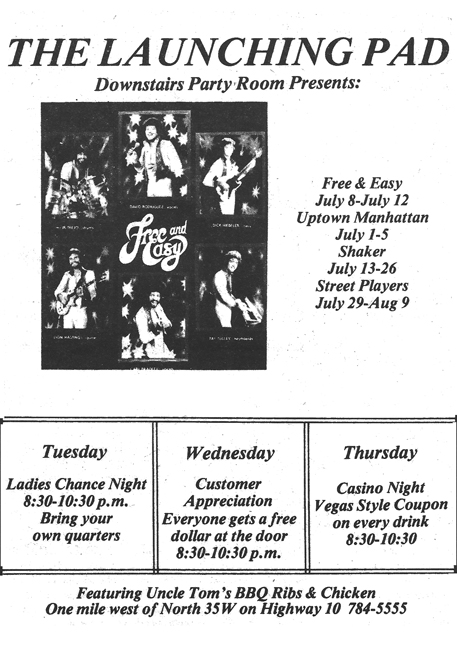
1978
In the summer of 1980, the Launching Pad was the site of an Auto Flea Market.
In 1981, after years of complaints, the City of Mounds View Failed to Launch a renewal of the Launching Pad’s liquor license. The list of grievances was damning against the owners.
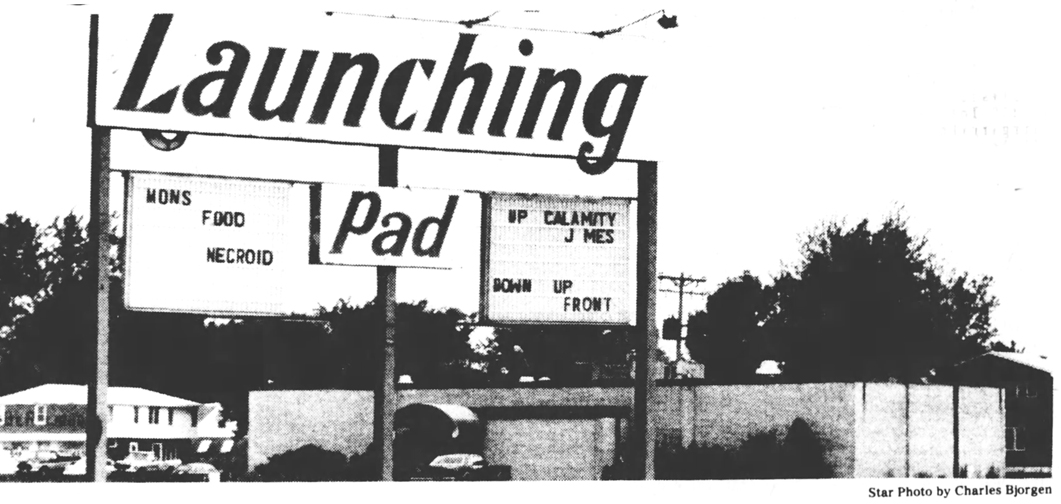
Minneapolis Star, June 4, 1981. Not sure what those words mean on the board thar….
Subsequent occupants of the site included:
- Povlitzski’s on Ten, 1981 – gone pretty quickly
- Loose Ends, owned by Janet M. Loosen – 1982 to June 1990
- Sold in January 1991
- Saturn of St. Paul as of April 1994
924 So. Robert Street, St. Paul. 1970: organ music.
1612 West Lake Street, was a coffeehouse with entertainment by folk singers in the fall of 1962. Very popular with St. Louis Park teens, despite the 75 cent cover charge. An article about folk venues in Life Magazine’s December 14, 1962 issue noted that Le Zoo was famous for its sing-alongs. The January 1963 issue of Select Twin Citian described a “Contemporary coffeehouse atmosphere with new faces in folk music and jazz Tuesday thru Sunday 8-12 pm. Sunday special – reserved seat matinees at 2 and 4 pm, presenting Maury Bernstein singing “Folksongs for People Who Hate the Kingston Trio’ in nine languages.” In March 1963 owners were Paul Hewitt and Willie Somdahl. It was still there in January 1964.
The main Leamington Hotel, located at 10th Street and 3rd Ave., was built in 1912.
For years the hotel did not have a liquor license because it was within 300 feet of a church. In 1954 the hotel finally convinced the City Council to amend the ordinance, and the license of Andy’s Bar was transferred to the Leamington. Andy’s was under fire because of indictments for watering down liquor.
The venues of the Leamington were:
IMPERIAL GARDEN
NORSE ROOM AND TERRACE
Music by the Gulbransen Theater Organ
March 1969: Bev and Terry
KAFFE KLATSCH
CROWN ROOM
RENDEZVOUS PIANO BAR
CARNIVAL ROOM
Kay Nygaard and the Sound Effect in 1969
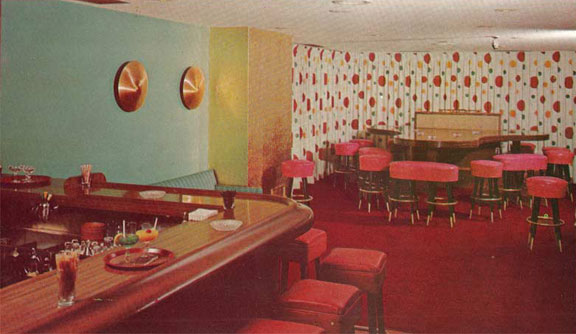
LEAMINGTON MOTOR LODGE
The Leamington Motor Lodge was at 400-410 So. 10th Street, and a much humbler project. It was built in 1962. It was most famous for hosting the Beatles in 1965.
In 1967 the cocktail lounge at the motor lounge featured Sonny Brown’s cool vocal styling with the beat of the jazz organ.
March 1969: Chris George at the piano bar
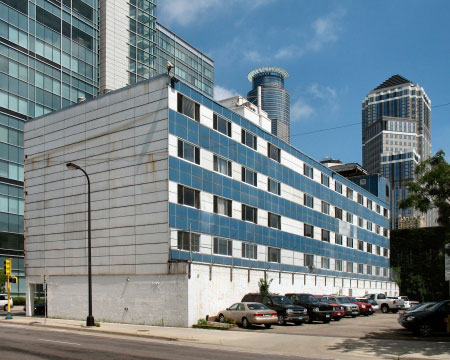
Leamington Motor Lodge
The Leamington Motor Lodge was demolished in February 2008.
Please see Koogan’s Leaning Post.
Lee and Eddie’s Longhorn Bar was located at 412 Cedar Ave. on the West Bank. This is not to be confused with the other Longhorn Bar at 14 South Fifth Street in Minneapolis.
There were a lot of different bars in this space over the years, and I’m sure I don’t have them all. Some of them sound very intriguing!
THE BUILDING
The 33′ by 100′ two story brick building was built in 1886-1887. In typical style, it had two storefronts on the first floor and apartments on the second floor. The storefronts were numbered 412 and 414 Cedar Ave.
In 1895, 412 was occupied by the Rood and Erickson clothing store.
In 1905 the building was sold to the Enger Bros. Undertakers and Embalmers for $4,500. 412 was used as their mortuary until April 1947.
Permit cards show other uses, which must have been in 414:
- Pool hall, 1934
- Cafe, 1934-1935
- Liquor store, 1937
- Tavern, 1937
- Cafe, 1938
LEE AND EDDIE’S
Despite the name Longhorn on the photo below, in newspaper reports, this bar was almost always just referred to as just Lee and Eddie’s. The first evidence of Lee and Eddie’s was a news report dated December 13, 1954, when a bartender was arrested and accused of selling 3.2 beer to two underage kids. He was fined $100.
Leave it to entertainment columnist Will Jones to give us a most amusing inside look at Lee and Eddie’s before it became a Country bar. This is long but worth it! (Minneapolis Tribune, October 15, 1958)
The Beat Beat: Lee and Eddie’s, a beatnik-type 3.2 hangout on Cedar avenue, now reserves Monday night as blabbermouth night for anybody who wants to get up and sound off on anything.
The man behind blabbermouth night is Lyle Tollefson, originally a Minneapolitan, but late of San Francisco, who descibes himself as a practicing member of the Beat generation and authority thereon. The conducted similar sessions in cellars in the North Beach section of San Francisco, he said.
Among his beat credits, Tollefson list himself as a member of the San Francisco committee that organized a Beatnik Tour of the Bourgeois Wastelands. The SF beatniks hired Grayline buses for the tour. Included were such events as poetry readins from the steps of the St. Francis hotel and a symbolic transference of bagels between the Co-Existence Bagel Shop, a beatnik establishment, and one of SF’s fancier bourgeois delicatessens.
On April 5, 1960, the bar’s 3.2 beer license was in jeopardy, although the article did not say why. The license was held by LeRoy Higgins.
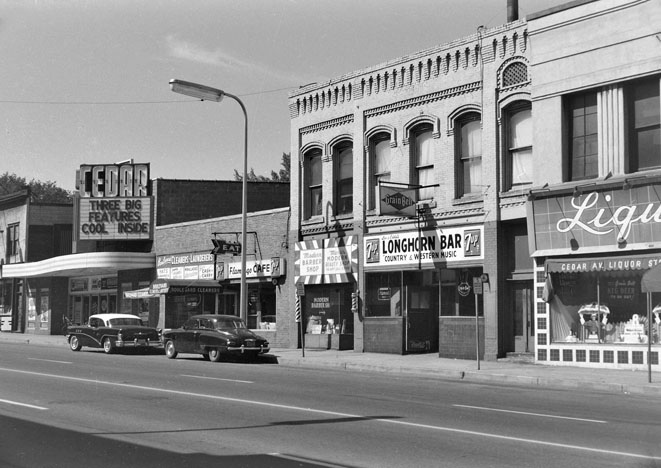
1960 photo courtesy Hennepin County Library, via James Orndorf
JAY’S BAR
The proprietor of Jay’s Bar was Gerald B. Flavin, who voluntarily turned in his liquor license when the Minneapolis City Council licenses committee recommended revocation. Flavin allegedly had financial ties with a pinball machine distributor, Walter Witt. Witt had loaned $1,000 to Flavin for the privilege of placing two machines in Flavin’s bar. Witt testified that this was a common practice that allowed distributors to help finance liquor and beer outlets in exchange for rights to place their pinball machines. The matter was put under investigation.
Meanwhile, Flavin was awaiting trial on a charge of receiving stolen property: two outboard motors, part of a group of 29 stolen motors. (Minneapolis Tribune, August 10, 1961)
THE SOUL OWL
This was the home of a group called The Poverty Players, perhaps similar to Dudley Riggs? A note dated January 28, 1962, said that the cast for that night included Jerry Nagle, Carole Sholander, Diane Bird, and Ivan Dusek. Also on the bill was jazz by the Jades. Reading about the Jades on minniepaulmusic.com, it doesn’t really appear that the Jades were exactly a jazz group, but I didn’t listen to the interview.
The next notice, dated February 4, 1962, called the place the Sour Owl – one or the other must have been a typo! The Poverty Players were again on the bill, taking on the topic of sin and censorship in the movies. Shows were at 10 pm and midnight, again with jazz by the Jades in between.
BAMBOO CLUB
One sorry but tantalizing classified published over three days in September 1962 tells us about this far out club:
Entertainment Fri., Sat., Sun. Jazzettes featuring Barry Lynch on trumpet. Coolest music in town.
SID’S 412 BAR
Sid was Sid Ackerman, and he owned his bar in August 1967. This information was revealed in an article about one of his barmaids (and his maid at home) who was writing the Great American Novel.
FIRE AND DEMOLITION
Fire destroyed the building on June 5, 1968, causing $50,000 in damage. A bar (Sid’s?) and a beauty shop were on the first floor. The second floor apartments were unoccupied.
EDNA’S PARK/EDNA MINI-PARK
Some news reports gave 412 Cedar Ave. as the address of Edna’s Park. This began in about July 1970 until about December 1973. Other descriptions of the park were:
- The Sixth Ward Playground
- Next to the Cedar Theater
- A half lot next to Edna’s Cafeteria
600 South Cleveland (at Ford Parkway) in St. Paul. This was mainly a restaurant, but had a grand piano in the dining room. Its history was given in an article printed in the Strib on January 19, 1987.
It was founded by Frank Lee as Lee’s Log Lodge in 1925.
In 1940 it became Lee’s Broiler
In 1944 it was renamed Lee’s Village Inn.
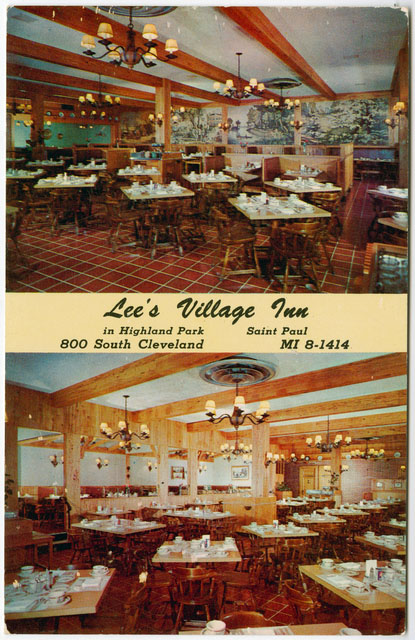
1965 photo courtesy Minnesota Historical Society
The images of the matchbooks below are courtesy of Gordon K. Andersen.
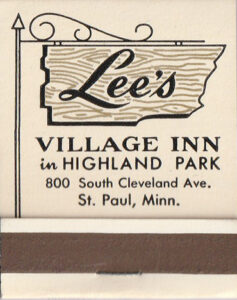
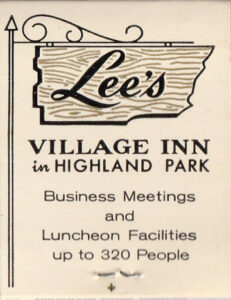
In 1987, the restaurant was owned by James Theros.
The Left Guard was a Supper Club located at 7717 Nicollet Ave. in Richfield, just over the Bloomington border.
The building started out as a Kroger grocery store, then a Piggly Wiggly.
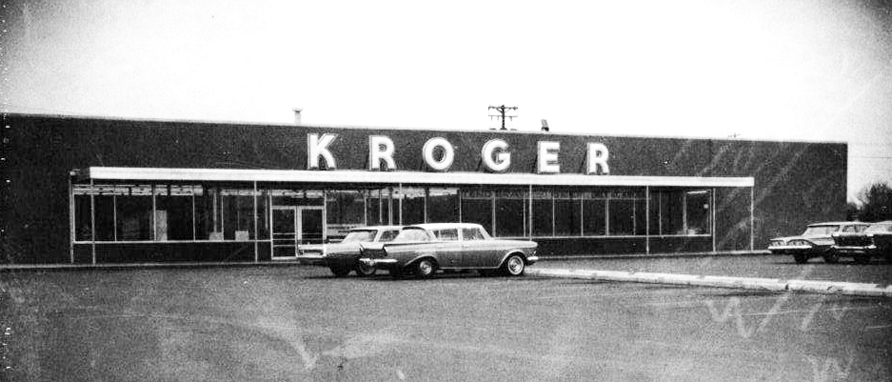
Image courtesy Richfield Historical Society
THE LEFT GUARD
In the early 1960s, Green Bay Packers Fuzzy Thurston, a left guard, and Max McGee, a wide receiver, and entrepreneur William “Bill” Martine opened an establishment called the Left Guard in Menasha, Wisconsin, where the Packers hung out. They created a chain of several Left Guard restaurants throughout Wisconsin, and a steakhouse with the same name in Richfield.
Max also had his own place called the Left End in Manitowoc, Wisconsin.
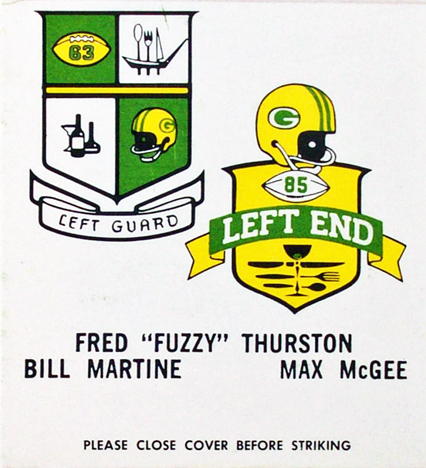
Image from the blog of David Galassie
The keychain below gives the names of the owners as Fuzzy (Fred Thurston), Max (McGee), Bill (Martine), and Karl (Kassulke, a Viking).
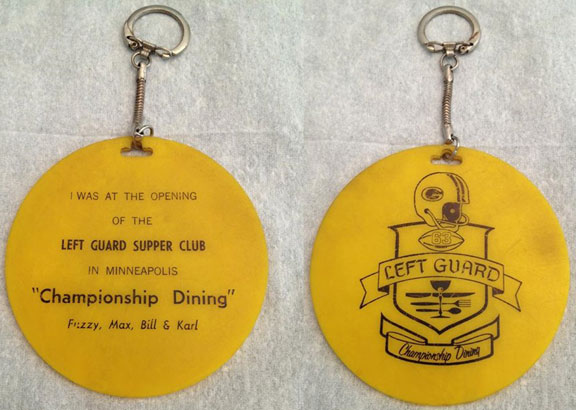
Image courtesy Michele Leahy DeVoll
Two Great Restaurants Under One Roof! One was called Martine’s, after Bill Martine, the only non-football player.

Ad courtesy Richfield Historical Society via Terry Ahlstrom
The Left Guard in Richfield drew celebrities and members of the Vikings back in 1973 to 1975. It looks like they had the sense to replace the Packers colors with the Vikings!
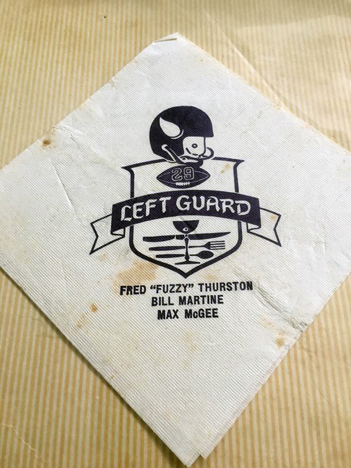
Image courtesy Ozzy Judge
MAXIMILLIAN’S AND CHI CHI’S
In 1975 the Left Guard group broke up and the Richfield property was divided into two different restaurants, served by one kitchen.
MAXIMILLIAN’S
From 1978 to 1982, half of the property was a private club called Maximillian’s, run by Max McGee. Max’s, as it was called by employees and regulars, was a posh disco – it is said that Time magazine called it the hottest singles bar in America at one point.
The descriptions below come from comments on Facebook and from an article by Karin Winegar of the Minneapolis Star (February 8, 1980).
Originally a private club open only to members and their guests, on slower nights you could buy a one night “membership” from $10 to $25 in 1979. Adjusting for inflation, it could get pricey just to walk through the door, not to mention valet parking and coat check. By 1980 Winegar reported that it was open to the public unless the house was packed, in which case it reverted to membership only. An annual membership was $100 the first year, and $50 each year after that. Membership perks included admittance to ski trips, fashion shows, and the like. It had a strict dress code of no jeans, turning away celebrities like Judy Carne in $300 denim, so they say.
Winegar went all out to describe Maximillian’s: “earth tones, plants, wicker, and the city’s largest macrame wall hangings” made up the decor. Then there’s the extravagantly dressed clientele, including visiting athletes, “numerous tall, elegantly dressed, hyperactive ladies who model occasionally,” and private disco instructors who “steal a quick turn on the floor for pyrotechnics before the crowd ruins it all.”
Friday night – date night – was the busiest, more than Saturday night. “If you sincerely want to dance, you have no business being at Max’s on weekends after 9 pm or so when DJ Ron Jackson spins the first songs out across the under-sized brass dance floor…. Fortunately, not everyone is a good dancer; there are thumpers and clumpers and water-treaders out there until closing each night.”
CHI-CHI’s
The other side of the building became the first of the Chi-Chi’s Mexican Restaurant chain. It was started by Marno McDermott, who named the place after his wife’s nickname (which, in Spanish, means breasts..). Chi-Chi’s was the area’s first sit-down Mexican restaurant and an instant hit – people would wait two hours for a table. At the time the price of beef was rising, and Mexican food was cheaper to produce. It’s said that in 1976, both restaurants made $4 million.
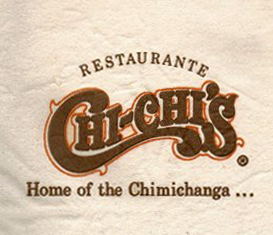
Image courtesy Karla Wilkie
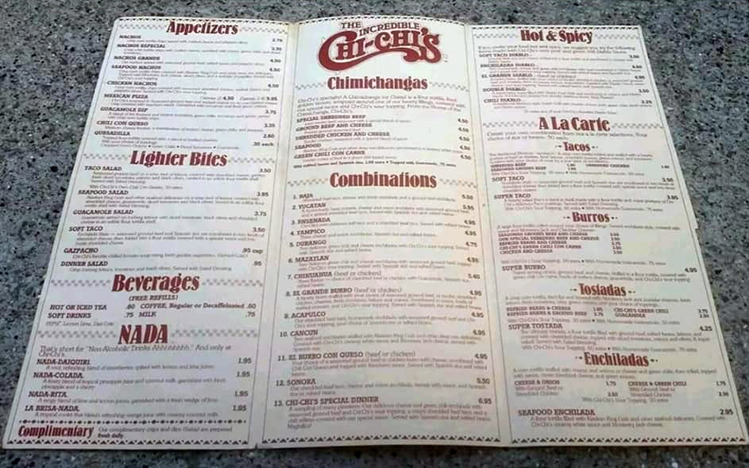
Image courtesy Scott Glenn
At the same time, Maximillian’s was closed and the Chi-Chi’s portion was expanded to the former Maximilian’s side of the building.
From this first location, Chi-Chi’s grew to 237 locations by 1986.
THE END OF CHI-CHIs
JUNBO
The building’s last iteration was the JunBo Restaurant.
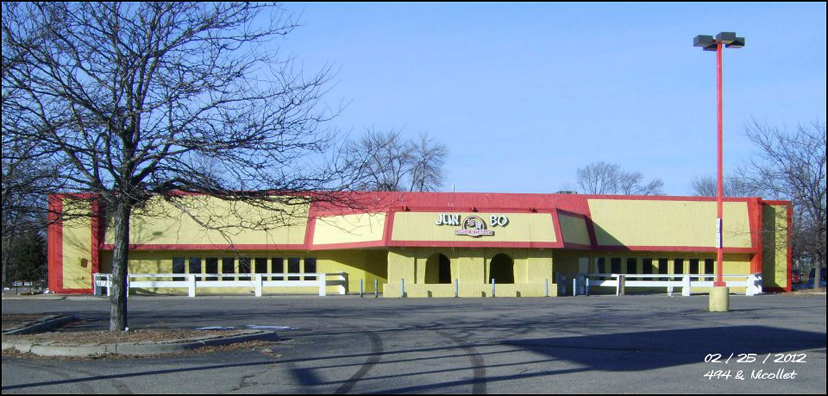
Jung Bo Restaurant, February 25, 2012. Image courtesy Shayne Hanson
The building was demolished on March 30-31, 2012, as documented by Brian Carlson.
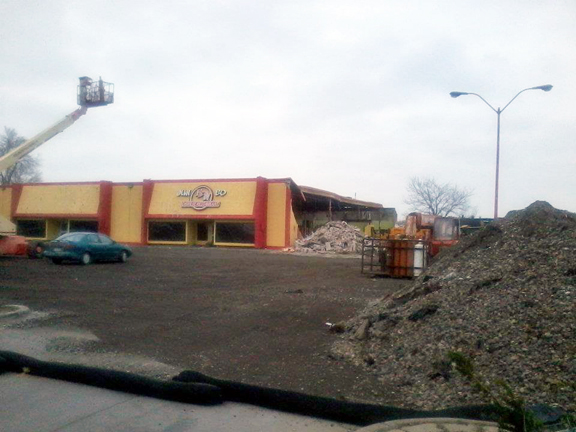
The existing Menard’s next door was also demolished and a new Menard’s was constructed that same year. The former Left Guard site was in the parking lot.
Save
Lefty’s Tavern at 22nd and Riverside offered entertainment by the “Tennessee Sweetheart” and “Manville, Pop-Eye Boy” on New Year’s Eve, 1941-42. Possibly the future home of the original Coffehouse Extempore?
This establishment was located at 438 Rondo Street in St. Paul, around 1922 and/or 1923. Proprietors were Mr. and Mrs. H. McCarty, and the Mr. C.P. Oden was the manager. Could this be Chet Oden, later of Road Buddies?
The Liberty Bar was located at 9 Ninth Ave. So. in Hopkins.
This lovely 3.2 bar was brought to my attention by Jim Klobuchar, in a paragraph he wrote in a story he published about the Bull Pen, down the street. It was irresistibly hilarious, and I had to look it up in the Strib archives.
Turns out there wasn’t much to find, except a string of men losing their liquor licenses for serving beer to minors. I’ll write down what I found, but it’s not too interesting.
In July 1953, Valentine C. Skoog sold the place to Percy Villa, who was the former boxing coach at Blake School. Villa’s real name was Bennie Percansky, and he was the brother of Abe and Raye Percansky, owners of the Flame Cafe at 16th and Nicollet.
In December 1961, Richard J. Strachota, a co-owner of the Bull Pen, had the license and got in trouble for selling beer to a minor.
In the Fall of 1962 the bar was operated by Harry C. Buechner. In May 1963 the City Council closed him down and charged him $100 for.. selling beer to a minor.
In November 1963 the the license was awarded to LeRoy R. Jensen, who was purchasing the property. At the time the bar was closed for 20 days, because Buechner had just committed his second offense of (let’s all say it together) selling beer to a minor.
THE SNAKE PIT
Okay, here’s the good part. I can’t improve on it, so I’ll just repeat it verbatim. This is Jim Klobuchar, Minneapolis Star, June 19, 1967:
For the tourist, no place in town is more enchanting than the Liberty Bar, styled the Snake Pit by casual passerby. The real insiders, however, refer to it as Reptile Gardens.
This is a delightful 3.2 bar where, on an off-night, I encountered only three fist fights, and one small threatened riot. For decor, the place achieves the subtly right counterpoint from the matched ribbons of flypaper danging from the ceiling on either side of the cash register.
The two-piece western band was largely ignored in favor of the more imaginative entertainment at the bar. “The joint owes me $5 for winning on the Twins in the pool,” a drunk was screaming at the bartender.
“Pipe down or I’ll call a cop,” the bartender snorts.
“Go to hell,” the customer replies fondly. “I never hit a man who has to wear a gun.”
And that’s it for the Liberty Bar, except to say that it was for sale in June 1974. Wish I had some photos! Maybe when the Hopkins Historical Society opens up again….
This is the history of two venues located in the building at 3901 Wooddale Ave. in St. Louis Park.
- Lilac Lanes Cafe
- King’s Inn
The building was part of a complex called the Lilac Lanes Shopping Center, which had a prime location at the Northeast corner of Highway 100 and Excelsior Blvd.
The 30,000 square foot shopping center was the first in the State, built in 1941. Unlike Miracle Mile, which was built across Excelsior Blvd. ten years later and is often cited as the earliest of its kind, Lilac Way was not so much a strip mall but a series of buildings anchored by the restaurant and bowling alley, and was much smaller that Miracle Mile’s 154,000 square feet. It was also not all built at one time but grew incrementally, and had standalone buildings.
FRANK THEROS
The Lilac Way Shopping Center was the brainchild of Frank Theros and Nick Phillips. Theros was born in Olibia, Greece, in 1898, and served in the US Army in France in World War I from 1918 to 1919. According to permit approvals published in the Minneapolis papers, he operated the Ha Ha (as in Minnehaha) Cafe at 2629 East Lake Street in 1927 and 1928, and in 1931 he owned the Stadium Café.
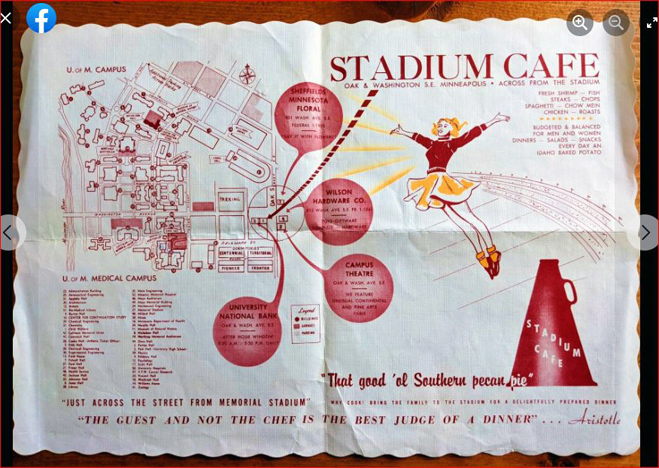
Placemat image courtesy Jeannie Theros Wallschlaeger
In 1931 the location of the Stadium Cafe was listed as 732 Washington Ave. SE at Oak Street SE, which is in the Stadium Village area of the University of Minnesota. In 1933, Theros is granted one of the first on and off-sale liquor licenses in Minneapolis, dated April 18, 1933, but the address is given as 314 14th Ave. SE, which is across campus in Dinkytown. However, from 1934 to 1937, he is listed again at 732 Washington Ave. SE. This building has been replaced by student apartments.
NICK PHILLIPS
Nicholas Basil Filosofopoulos was born in Tripolis, Greece in 1891. It is unclear whether he served in World War I, as his record only shows a “Military Date” of December 21, 1918. On his military registration card in 1918 he wrote that he worked at a restaurant.
In the 1930s he lived at the Curtis Hotel in Downtown Minneapolis and worked at the cigar stand in the lobby there. On his World War II draft registration card he wrote that he worked at both Lilac Lanes Cafe and the Curtis Hotel. In about 1940 he moved to St. Louis Park.
Phillips died in June 1958, and the Lilac Way Shopping Center went to his wife Elly.
The Lilac Lanes Cafe/Kings Inn stayed in the Theros family. Frank’s son George took it over from Frank.
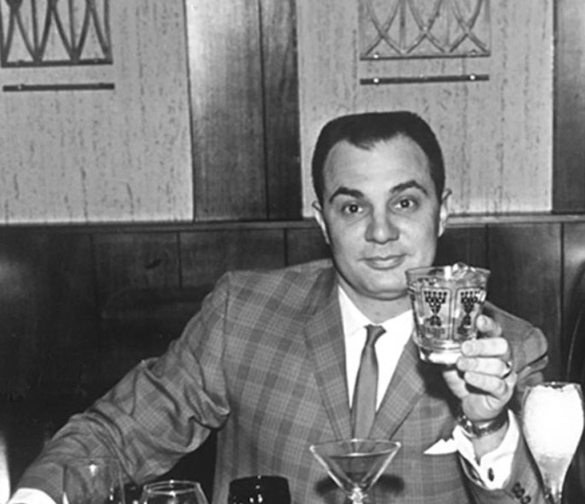
George Theros – Photo courtesy Jeannie Theros Wallschlaeger
LAYOUT
The complex was built to go around the corner. In the photo below, the road in the lower left corner is Excelsior Blvd., which was known as Highway 212 at the time. The road at the very top is Highway 100. Parallel to Highway 100 is a service road (now Park Center Blvd.) that was called Wooddale Ave. The large white building facing Wooddale/Highway 100 was called the Lilac Lanes Recreation Building in the initial ad announcing the opening date. The rest of the complex was the Lilac Way Shopping Center. Although many of the stores faced the service road, they all had Excelsior Blvd. addresses.

Photo courtesy St. Louis Park Historical Society
LILAC LANES BOWLING ALLEY
The first business to open at the site was actually the bowling alley, with 20 Brunswick Centennial maple lanes. It opened on December 12, 1941, with St. Louis Park Mayor William Martin “trundling” out the first ball. The new facility featured an automatic electric foul line, locker rooms, fountain, and promised a cafe. Al Borreson was the manager. (Minneapolis Tribune, December 1941)

Minneapolis Star Journal, December 25, 1941
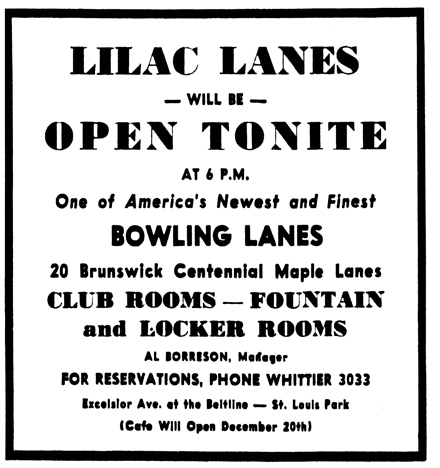
Minneapolis Tribune, December 12, 1941
The long section facing Wooddale/Highway 100 was the Cafe. Stretching back behind it, where you see the sign “Ample Parking” in the photo below, was the bowling alley.
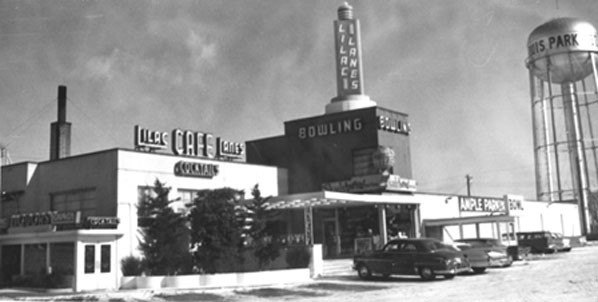
1960 photo courtesy the St. Louis Park Historical Society
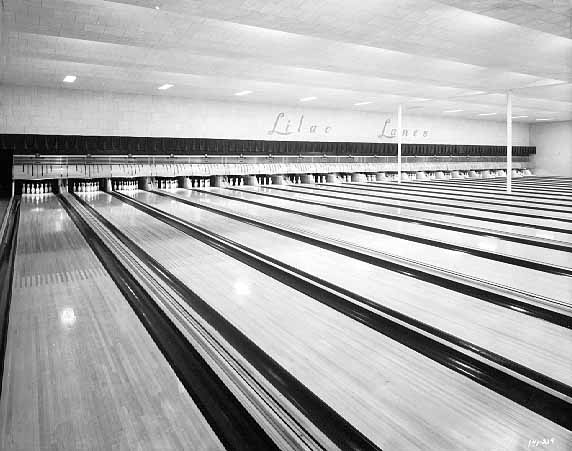
Lilac Lanes Alleys, March 20, 1942. Photo courtesy Minnesota Historical Society
One report (no citation) said that in 1942 the bowling alley was managed by golf pro Jimmy Lentz.
In January 1943, the bowling alley was under new management but must have closed shortly afterwards; a report says that it closed for a year and a half and reopened on September 1, 1944. The reasons were probably War-related.
In 1949 All Borreson was again the Alley Manager. This information must have come from the St. Louis Park Dispatch.
LILAC LANES CAFE
1941
The Cafe came soon after, opening on December 27, 1941. The Cafe was sometimes referred to as Lee’s Lilac Lanes Cafe – it has yet to be discovered who Lee was.
1942
There was another opening on September 5, 1942, under the management of “your genial host Connie Rallis.” The menu included frogs’ legs. (St. Louis Park Dispatch)
1943-1944
As with the bowling alley, reports are conflicting. Near as I can tell, it opened under new management in January 1943 but closed that same month. Reasons for bad business were the war (suburban restaurants needed tires and gas to get to), and the Cafe did not have a liquor license.
1944
The Cafe and the bowling alley reopened on September 1, 1944.
1945
In December 1945, it was announced that two men who had fed thousands of war plant workers during the War, had taken a five year lease on Lee’s Lilac Lanes Cafe. Walter Claasen of St. Paul had been the manager of the cafeteria at Northwest Airlines’ St. Paul bomber modification center. Rudy Engelhart of St. Louis Park had been the cafeteria chef. (Minneapolis Tribune, December 15, 1946; St. Louis Park Dispatch)
1947
The menu in 1947 included:
- Omelette with Chicken Livers and Fresh Mushrooms
- Butter Fried Calf’s Liver, Breakfast Bacon, Bermuda Onion Rings
- Fried Jumbo Green Shrimp
- Grilled Filet Mignon, Bordelaise Sauce
- Broiled Choice T-Bone Stead from our Rotary Grill
Other treats included Navy bean soup, Crabmeat Cocktail, Glazed Parsnips, Prune Whip Pie, and Orange cake with boiled icing. Children got a choice of calf’s liver or chopped sirloin.

Top of Lilac Lane Cafe Menu, January 1, 1947. Image courtesy St. Louis Park Historical Society
1949
Business was bad. Still no liquor license, and the Cafe was reduced to reducing prices and urging families to bring their screaming kids.
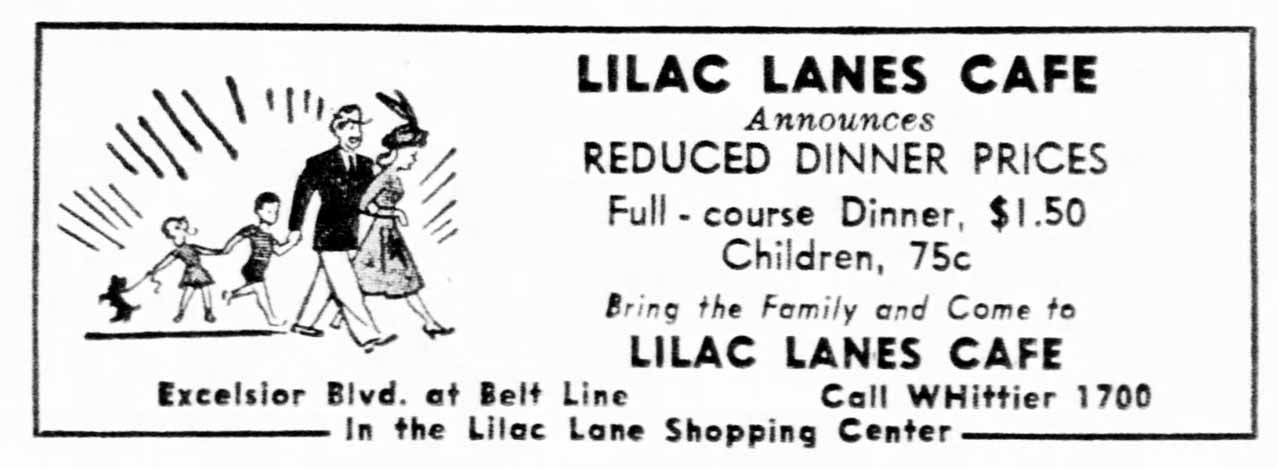
Minneapolis Tribune, October 9, 1949
1950
The Federal Census put St. Louis Park over the 10,000 mark at last, and according to State law, that meant that instead of only being able to grant five liquor licenses, it could now issue ten. Although there were plenty of places that could serve 3.2 beer, the ability to serve hard alcohol could make or break a bar or restaurant. In addition, tied to the license was a dance permit. Even in staid 1950, people wanted to dance!
1951
LILAC LANES CAFE GETS A LIQUOR LICENSE
Nick Phillips, who held the license to operate the Cafe, applied for one of the five newly-available liquor licenses. On December 10, 1951, the Village Council granted him a “limited license” for liquor service to patrons seated at tables for food service. They could not drink at a bar, nor could they dance. And of course, they could not drink on Sundays.
Voting against this monstrosity was Councilman Torval Jorvig, who never saw a bar he didn’t want to close. He was joined by Clerk Joseph Justad. The leaders of three nearby churches were also up in arms about this decision, arguing that the Council had used the license to bail the Cafe out of its financial difficulties. In addition, two Councilmen who voted for the permit were due to resign at the end of the year, and the pastors said that the new Councilmen might have voted differently.
Mayor O.B. Erickson pointed out that the area was 100 percent commercial and there were no houses anywhere near the Cafe. “The area to the rear is all industrial and commercial and there probably never will be any residences there.” In addition, Phillips had been a St. Louis Park resident for 20 years, which was taken into consideration. (Minneapolis Tribune, December 12, 1951)
On December 13, 1951, Phillips paid $1,000 of the $2,000 fee for the on-sale liquor license, with the other half due in mid-June 1952. Phillips said it would would take two months at the earliest before he could finish remodeling and start serving liquor at Lilac Lanes. He planned to separate a downstairs ballroom from the bowling alley with a new wall and provide outside entrances for each. He also planned to remodel the front of the building. Food and liquor would be sold at tables in the downstairs ballroom (measuring 88 x 40 feet) and in upstairs dining rooms.
“It means everything to me to run a nice place in an atmosphere of good will. I’m not going to run a joint,” he said. (Minneapolis Tribune, December 14, 1951)
1952
The Lilac Way Cocktail Lounge had its Grand Opening on April 17-19, 1952.
Now, subsequent ads didn’t show this poor waiter with a black eye, I chose it since this was the first one in the series. Although I’d like to think the dessert lady gave him what for when he was too free with his hand…
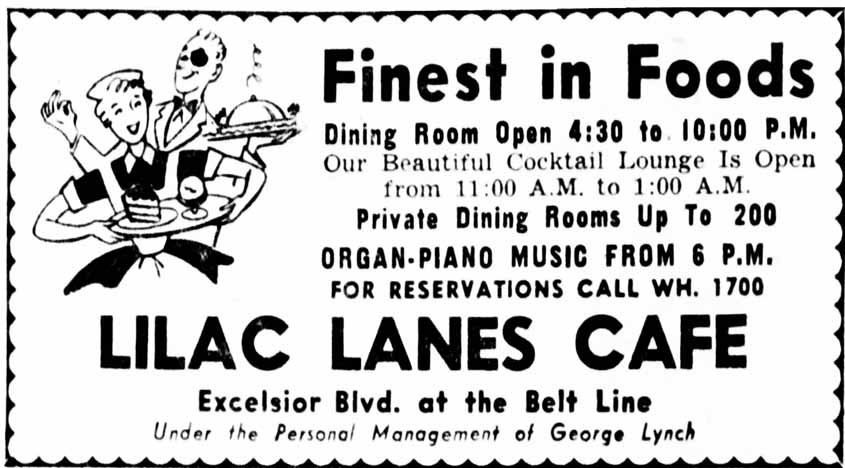
Minneapolis Tribune, September 11, 1952
1953
In 1953 Phillips petitioned to have the liquor license transferred to Lilac Lanes Enterprises.
In February the St. Louis Park Village Council turned down Phillips’ request to change his license from restricted to unrestricted. He still could not sell liquor at a bar at the Cafe. (Minneapolis Star, February 3, 1953)
As if to prove that his place was cool, calm, and collected, Frank Theros wrote a letter to the editor describing how 200 graduating seniors came to the Cafe at 5am as a part of their all-night party, “still full of pep.” He insisted it was a wonderful group, and there was “no rowdyism, no damage done, no breakage or taking of souvenirs. Our boys and girls do conduct themselves as ladies and gentlemen.” (Minneapolis Tribune, June 14, 1953)
1954
Restrictions on the Cafe’s liquor license were finally lifted by the St. Louis Park Village Council on January 11, 1954. The Cafe’s lounge had been the only one of six on-sale liquor establishments that were not allowed to sell drinks at a bar.
1955
Dinner music continued into 1955.
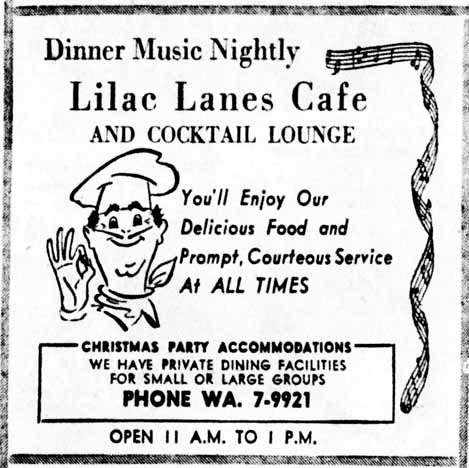
Minneapolis Star, December 1, 1955
1958
On June 27, 1958, Nick Phillips died at the age of 67.
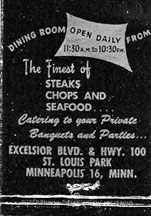
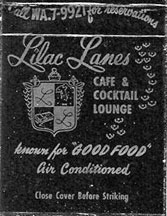
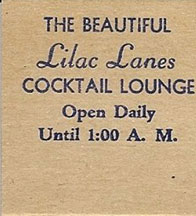
1961
At this point it is difficult to find ads for the Cafe, simply because they chose to write their name in script, which isn’t picked up by the search engine on the newspapers.com database. Obviously sometime between 1955 and 1961, dancing was instituted, as well as the Jolly Note Piano Bar. Plus “smooth melodic music” at dinner.
Some other “Rooms” of note were the:
Esquire Room for men only, and the Stag Room for parties. I can’t imagine what the difference might be. If anyone knows what these men did in these rooms, please let me know.
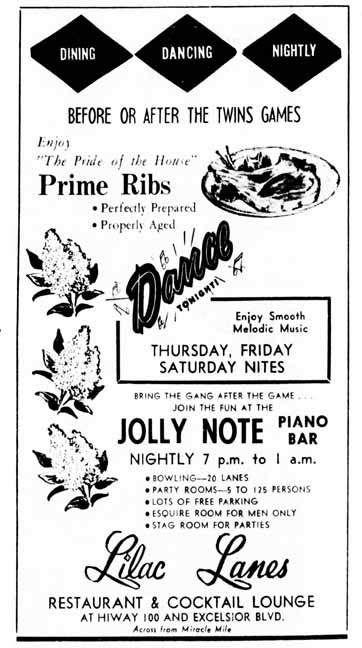
Minneapolis Tribune, April 16, 1961
And for a while, there must have been a policy of bringing in semi-big names to entertain the folks. Sophie Parker appeared at other clubs around town.
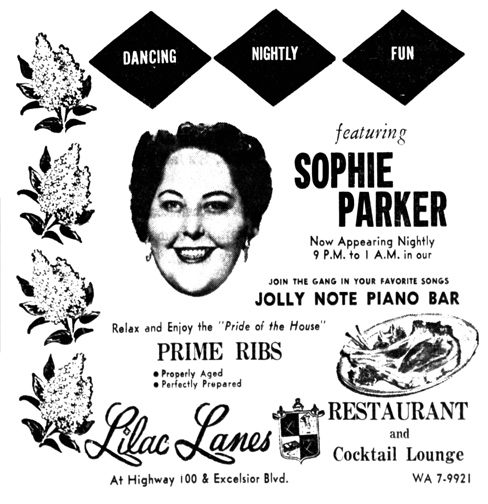
Minneapolis Tribune, July 10, 1961
1962
Jimmie Bowman was another local celebrity who entertained at many clubs around town.
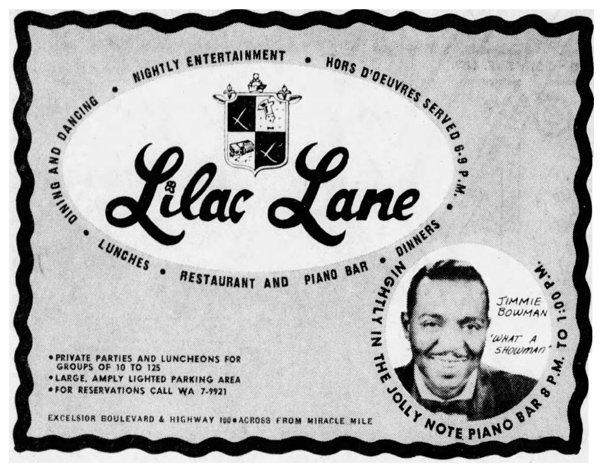
Minneapolis Star, September 6, 1962
1963
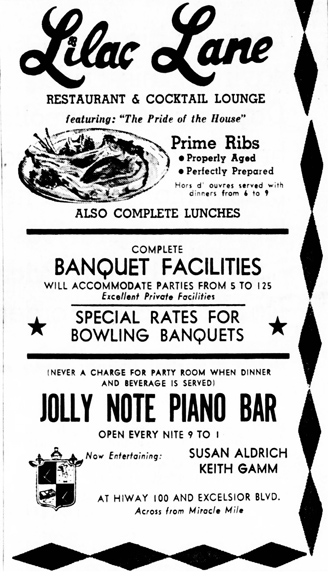
Minneapolis Star, February 7, 1963
The dining room and bar area were remodeled in the fall of 1963.
1964
FIRE DESTROYS THE CAFE
In the early morning hours of Sunday, January 5, 1964, fire destroyed the Lilac Lanes Cafe and slightly damaged the bowling alley. St. Louis Park police officers were cruising by at 3:30 am and noticed that the front window had blown out of the building and called it in.
George Theros reported that four bars on the first floor, the Cafe (seating capacity 227), and four party rooms (capacity 220) were destroyed, at an estimated loss of $250,000. Other estimates were $100,000 and $200,000.
The bowling alley was covered with soot and had smoke damage, but Theros hoped they would be usable by that evening.
The fire started in the Cafe, possibly from a combination of faulty wiring and a gas leak. (Minneapolis Star, January 6, 1964)
On January 7, 1964, the Star published a photo of one of the cash registers, keys melted from the heat.
THE KING’S INN RISES FROM THE ASHES
After nine months of rebuilding, George Theros completely redesigned the Lilac Lanes Cafe and renamed it the King’s Inn. No longer a Cafe, it was an elegant dining establishment, impressing both entertainment reviewers Don Morrison and Will Jones with its class and opulence.
Morrison called it 1960s Posh, with paneling, fancy light fixtures, rich carpets, and opulent materials on the walls, ceiling, chairs, and tables. The menu was unique – a velvet-textured crimson scroll tied with a gold cord that you unroll to view the bill of fare. The choices were limited, but a favorite was a dish called Eurasian chicken, which was – an entire chicken.
Jones also used the word Posh, and appreciated that the booths were actually comfortable. Some of the booths were actually styled like thrones. He tells us that famous kings “glowered benignly” from mural panels, and that he dined under the nose of Louis XIV. (Minneapolis Star, September 12, 1964); (Minneapolis Tribune, October 18 and 20, 1964)
The King’s Inn became known for many things. One of the most memorable was its salad bar, said to be the first and longest in the area, boasting 76 items. Their motto was “Food Fit for Their Majesties – Our Customers.”
Another was some famous regular customers. TV movie host and pitchman Mel Jass was seen at the King’s Inn – did he really bring his little dog?
1968
Over the years, there were various “Rooms” designated, as mentioned in 1961 with the men’s Esquire Room and the Stag Room. From at least 1968 to at least 1971 there was the Gourmet Room.
In 1968, the Sun Newspapers published an ad with a photo almost identical to the one below, with the tag line, “The Only Twin City Dinner Worth A Tux.”
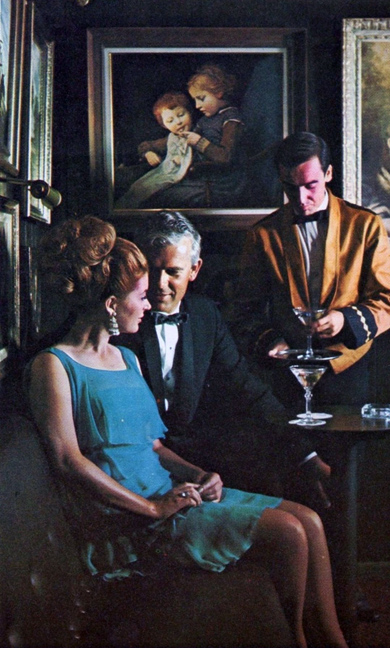
1971 Photo from “Minneapolis, City of Lakes”
The copy read:
You’ll believe you’re wearing a tuxedo after this elaborate continental dinner served with four full bottles of wine. Cheese Fondue, French Escargots, Coquilles, Goddess Salad, Tenderloin Habachi, and Alaskan Flambe courses handsomely presented with wine . . . . . . . Reservations preferred for this leisurely intimate dinner.
One fellow said there was a dress code and if one didn’t show up with a jacket, one would be supplied. But probably not a tuxedo.
1970
In an article dated December 11, 1970, Don Morrison of the Star reported that he went to check out the new St. Paul branch of the King’s Inn, only to find that it was the old Conroy’s. Although he had nothing but great things to say about it, the St. Paul branch was gone by 1972.
1973
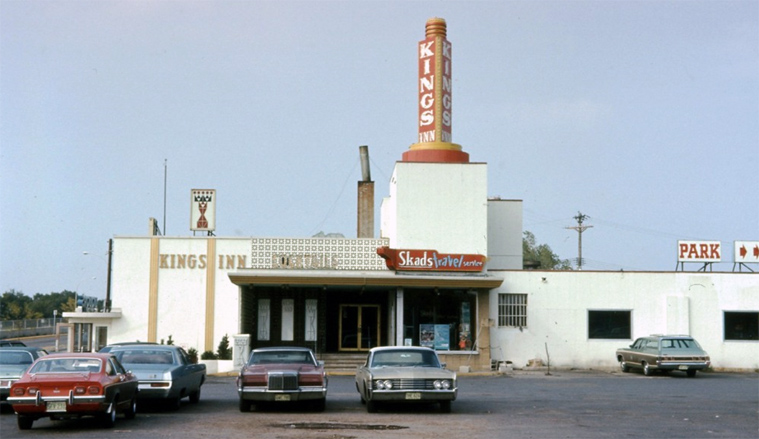
1973 photo by Emory Anderson
THE END OF THE INN
In the mid 1970s there was increasing talk about designating an Excelsior Blvd. redevelopment district, which threatened the continuing existence of Lilac Way. Despite efforts of many of the merchants to hang on (the King’s Inn did not participate), the old shopping center was ripe for redevelopment. Construction of the 36th St. overpass wreaked havoc on traffic in the area, and the businesses never recovered.
The complex was demolished in September 1988. (Demolition was delayed in the fall of 1987 when soil borings revealed high levels of trichloroethylene.)
The land lay vacant for a long time as many different proposals for redevelopment came and went. Finally, the Park Commons project came into being in the mid 1990s.
CODA
George Theros opened a King’s Inn on Highway 7 and Williston Road after the St. Louis Park location was closed. It became a Famous Dave’s.
The building at 320 Cedar Ave. So. had some different iterations:
LINDY’S BAR AND LOUNGE
“Just across the bridge.” This dates back to at least November 1952, when you could dine and dance to the Collegians, as advertised in the Minnesota Daily. October 1953: “Winnie will sing your favorite tune – come in and sing.” But it must have changed owners, as it was billed as “Eddie’s Newest Nightmare” on March 11, 1954, with music by Jimarlen Trio of KSTP Channel 5. Fizz – Fun – Frivolity – Refreshments.
[There was another Lindy’s that became Augie’s].
NEW HOLLAND BAR
February 1963. Bill “Boss” Gordon and His LaBombas played Caribbean and Latin music: “Come see and learn the new dance craze – Limbo.”
Located at 5346 West Broadway in Robbinsdale
1950
The Lion’s Den was located at 1160 Frost Ave. (west of English) in Maplewood, by Lake Phalen. The building was formerly a VFW Hall.
START-UP
An article in the Minneapolis Star dated April 3, 1964, announced that the new teen club had been approved by the Maplewood Village Council, and that it was expected to open on May 2. It would be owned and operated by four young men: Joseph Chenoweth, 18; Thomas M. Smith, 22; Jack Tucci, 17; and Peter M. Dahlin, 17.
It was planned to have an adult night club atmosphere, with everything except alcohol. Pizza and burgers would be served, along with soft drinks and “non-alcoholic cocktails.” Someone remembered Ginger Beer.
The article attributed the idea to Chenoweth, who was a freshman at the U of M at the time. He and Smith estimated that the cost of operation would be $500 per month, excluding the cost of bands. At first, financing would come from personal savings and “some parents’ help.”
MEMORIES OF THE LION’S DEN
Harold Kempka remembers that their radio ads always played “The Lion Sleeps Tonight” by The Tokens. He also says, “ What was cool was that kids from different high schools got together for a fun evening and as far as I can remember, there were very few fights or disturbances.”
By 1966, the Lion’s Den was one of three teen clubs in the Twin Cities. Bands that played there included the Deacons, the Lancers, and the High Spirits, who were featured in a spread in the March 20, 1966, St. Paul Sunday Pioneer Press.
Facebook memories include the fact that it was very HOT in the summer – there was air conditioning, but it was inadequate to handle a bunch of hot, sweaty teens.
It was also LOUD, with the amps overwhelming the rather small space.
And it was a place where Baldie and Animal boys and girls apparently coexisted in peace and harmony…
THE LANCERS
One of the bands that played there was the Lancers, and Gerry Francis of that group recently posted some great photos taken at the Lions Den on Facebook.
This first one is of Jen and Tom. Jen was always at the Door selling tickets to get in. I’ve lightened it up a bit so you can see the inside of the room better.
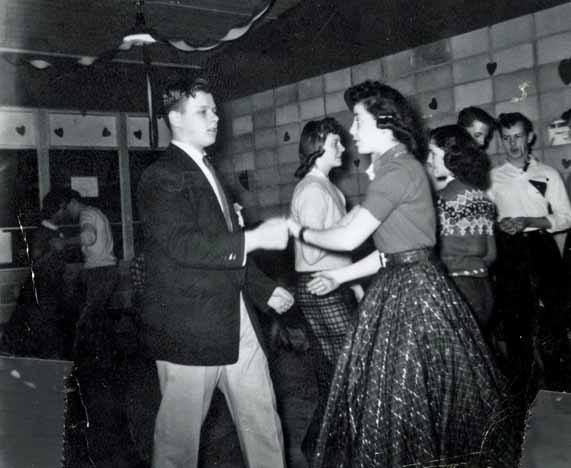
Photo courtesy Gerry Francis
And below is a photo of the Lancers themselves in 1964: Gerry Francis, Bob Ramsey, Lorenzo Whitmarsh, Bruce Pedalty, and Clayt Brunette.
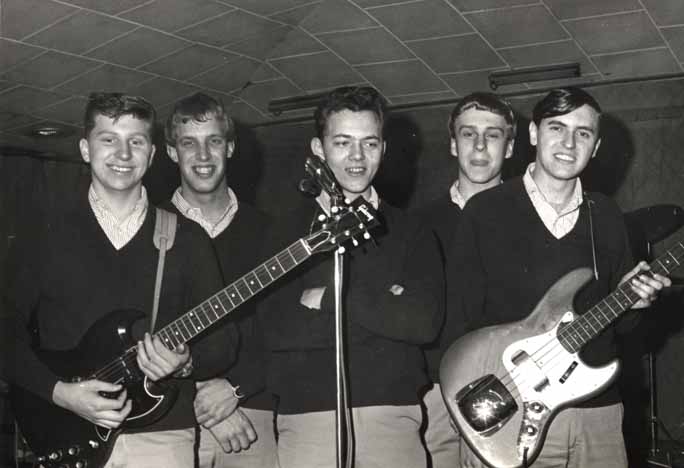
Photo courtesy Gerry Francis
By March 1971, 1160 Frost Ave. in St. Paul was the address Arctic Midwest Distributors.
724 – 4th Ave. So.
1969: Dave Rooney Trio
The Loeb Arcade Building and the Hale Block were located at the corner of Hennepin Ave. and So. Fifth Street in the heart of Downtown Minneapolis. The Hale Block, on the corner, was nestled inside the Loeb Arcade. Sadly, the area is a parking lot now, but had been a hotbed of entertainment in the heyday of Minneapolis.
MUSIC VENUES IN THE HALE BLOCK
This page is about the history of the Loeb Arcade and the Hale Block only. There were three addresses in the Hale Block that provided entertainment to the people of Minneapolis and beyond. Because the length of this page got confusing and out of control, I’m going to put each address on a separate page. I hope this causes no inconvenience. Those addresses are:
THE LOEB ARCADE
In February 1914, a permit was issued to demolish buildings at 509 Hennepin and 7 – 13 So. Fifth Street. These were brick buildings that had been built between 1898 and 1906.
In their place was built the Loeb Arcade, an L-shaped building that literally surrounded the Hale Block. It also had frontage on Hennepin Ave. and So. Fifth Street. The addresses of the Loeb Arcade were 509 – 513 Hennepin Ave. The Loeb Arcade Building was a neo-shopping mall, built by L.S. and S. Loeb of Duluth. L.S. Loeb & Co. was incorporated in 1905 and made some manner of liquor.
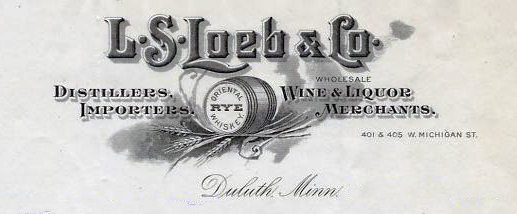
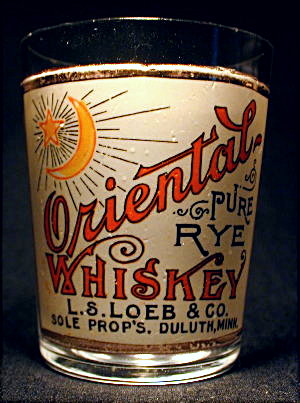
The architect was Ottenheimer, Stern, & Reichert. It was built out of concrete and was five stories high. In late 1913, the Loebs estimated the construction cost to be $300,000. An ad in the Minneapolis Journal (November 8, 1914) indicates that the actual cost came in at $750,000. The building opened on November 7, 1914. In 1922 there was a $40,000 addition to 511 – 513 Hennepin Ave. (88’ x 157’).
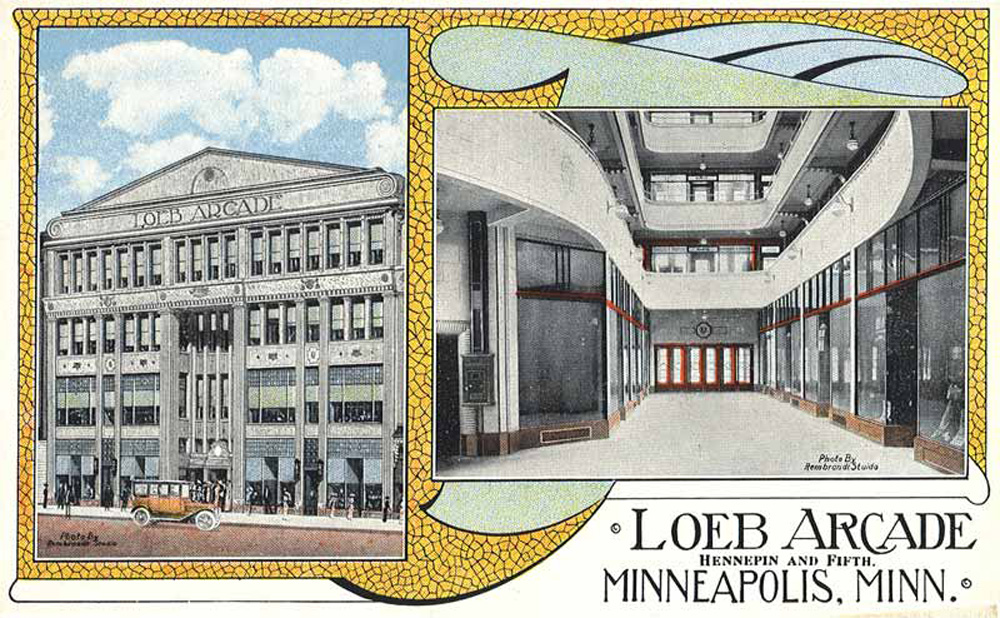
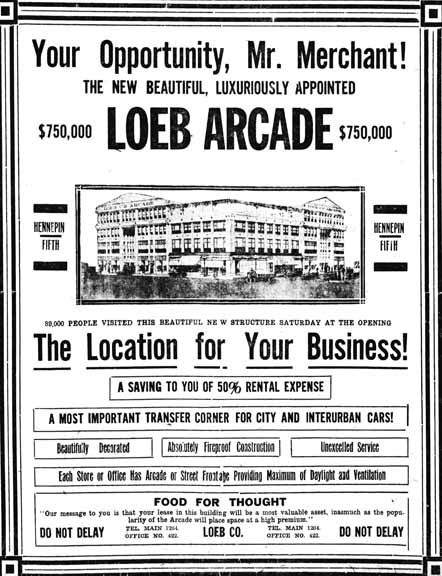
Minneapolis Tribune, November 8, 1914
A program described the building:
With reference to the Minneapolis arcade, this structure is pleasing in its modern architectural beauty and represents an investment need bring $750,000. Four stories in height of modern fireproof steel and concrete construction, the exterior is done in a brown Terra-cotta. Spacious entrances on Hennepin Avenue and 5th Street respectively admit into a equally spacious corridor of mosaic flooring presided on either side, according to the arcade idea, by the continuous chain of storerooms appointed in mahogany and white marble basing the corridor some eighteen feet in width leading from street to street affords a convenient meeting place or shelter from the weather and is a shortcut to those passing through.
An upward glance discloses a tastily conceived color scheme of striking white and camel Terra-cotta with rich green and brown Three large balconies completely circling the corridor on either side and bridged at the center of the building permit the comparison of a beautiful amphitheater lighted by a continuous skylight at the top of the structure. A most modern lighting system proves the building is successfully lighted by night as by day.
In his book Lost Twin Cities, Larry Millett explained that the building was patterned after indoor malls built in Europe in the late 18th Century, which had shops “stacked several stories high.” Those malls in Europe catered to the wealthy, but the stores at the Loeb Arcade were aimed at the middle class.
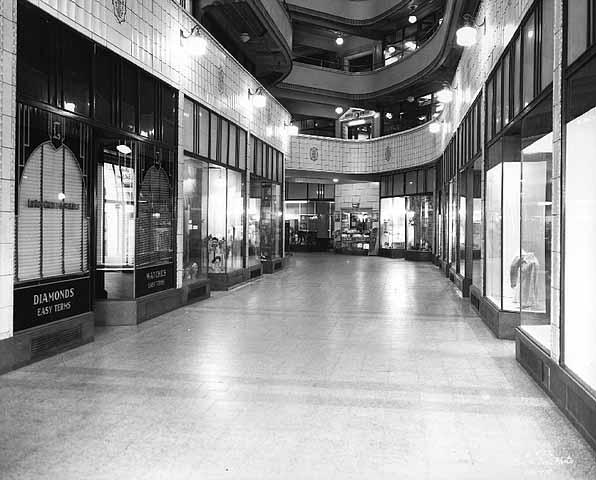
Loeb Arcade lobby, January 1952. Photo courtesy Minnesota Historical Society
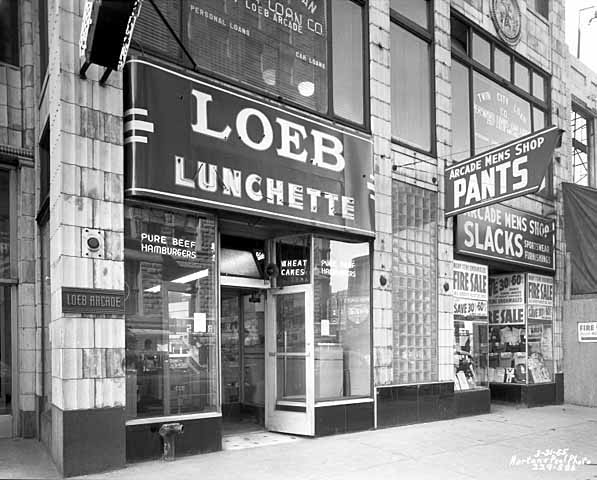
One entrance to the Loeb Arcade on Hennepin Ave., 1955. Photo Courtesy Minnesota Historical Society
Northern States Power had leased about 70 percent of its space, but when it moved to its new headquarters at 414 Nicollet Ave. on about September 1, 1965, the building was left empty, and its building manager stated that it had “no value.”
The Loeb Arcade commenced demolition on March 7, 1967. A large photo of the rubble graced the front page of the Minneapolis Tribune the next day. The first demo permit was taken out on December 30, 1965, but a final lease held up the wrecker for a year. A second permit, with another company, was taken out on November 4, 1966.
Below is a 1967 photo of the remaining Hale Block, where you can see the remains of the Loeb Arcade’s higher floors on the next building.
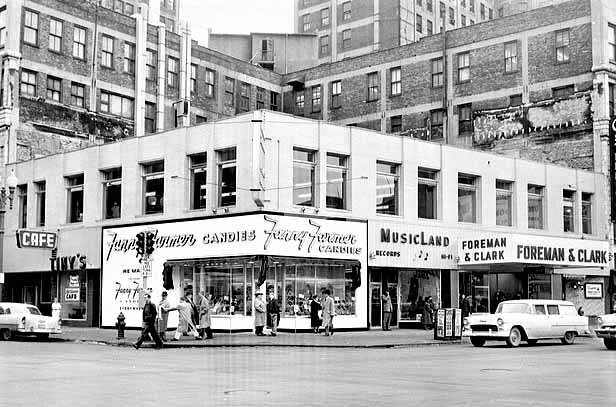
Photo courtesy Minnesota Historical Society
THE HALE BLOCK
The so-called “Hale Block” stood right on the corner of Fifth and Hennepin. It was completed in March 1880, with seven stores on the first floor, and ten “French flats” on its second and third floors. The idea of putting apartments above stores was innovative at the time, and the Minneapolis Tribune gave it a glowing review when it opened. (March 12, 1880) The architect was the renowned L.S. Buffington, who listed the building in his advertising. It was constructed by E.A. Harmon. The addresses of its storefronts were 501 to 507 Hennepin and 1 to 7 So. Fifth Street The building measured about 60’ x 60’ and was three stories tall.
Like any commercial building, the Hale Block (there were other Hale Blocks, including one in St. Paul) had a variety of different businesses. It also had its share of tragedies. Here are some highlights in its early history:
- In March 1887, a company in Philadelphia made an offer to buy it, tear it down, and build a 10-story office building. Owners E.A. Harmon and his uncle turned it down.
- On September 20, 1887, Phineas Chamberlain, a distraught attorney from Vermont, ended it all by jumping from his third floor window.
- In March 1890 the building was quarantined for measles.
- On August 7, 1890, a storm likened to a cyclone lifted the roof several inches off the building, scaring the bejeepers out of the people inside.
- In November 1896 the building was owned by S.S. Sprague of Rhode Island, as revealed because he died right then.
- On March 19, 1899, a night time fire required firemen to rouse sleeping residents and carry them down ladders to safety. At the time the building was owned by Charles H. Sprague of Rhode Island.
- In September 1901 it was purchased by the Consolidated Land Co., headed by Henry Sprague of Rhode Island.
- In July 1903 the Hale Block was remodeled to add two new stores on the Fifth Street side and expand a storefront on the Hennepin side. Permit cards are unclear whether the dimensions of the building changed.
- On January 25, 1913, L.S. and S. Loeb, who were building the Loeb Arcade around the building, negotiated a 100-year lease from the Consolidated Land Co. The Loebs (again) planned to tear down the building and build a vaudeville theater.
- When the new Loeb Arcade opened on November 7, 1914, once again the Hale was not expected to survive: “Pending the expiration of leases in the building that occupies the corner space, the Arcade will remain as it is. Later it will be added on to by the construction of a building of similar architecture on the corner.” (Minneapolis Tribune, November 8, 1914)
- On June 29, 1921, the Hale Block suffered a devastating fire causing $300,000 in damage and injuring four firemen and the proprietors of two businesses. Fireworks sold in Silverman’s Grocery Store were set off by the flames, making it a spectacular sight, and firemen had a difficult time keeping spectators away. (Minnesota Daily Star, June 30, 1921)
- On December 3, 1926, the Loeb Arcade Building Corp., a group of Minneapolis investors, bought both buildings from the Loebs. The cost was $500,000 for the buildings and $200,000 to buy out their 100-year lease. The new owners, for the third time, planned to tear down the poor Hale Block, and (again) build a 10-story building on the site. The combined footage was 140’ on Hennepin Ave., 157’ on So. Fifth Street, and 192’ in the alley.
- In 1951 the Loeb Arcade, including the Hale Block, was purchased by a syndicate headed by Julius Epstein of Chicago for about $600,000.
FIRE AT THE HALE BLOCK
On October 25, 1954, a spectacular fire swept through the original 1880 Hale Block, totally destroying the three-story building. Ten businesses were destroyed:
- Vic’s Restaurant and Cocktail Lounge, 507 Hennepin
- Foreman & Clark men’s clothing store
- Fanny Farmer Candy shop
- New West Shoe Repair shop
- Sunshine Florists, 503 Hennepin
- Arcade Men’s shop
- Loeb Luncheonette
- Twin City Loan Co.
- McGlynn Bakery
The first alarm came in at 1:36 am. Two more alarms came in within minutes, plus two more alarms for special equipment. A total of 23 fire rigs were on the scene – about three-fifths of Minneapolis’s fire equipment. The rigs and hoses totally blocked off Hennepin Ave.
There was smoke damage to the adjoining Loeb Arcade building, where NSP housed its main office and employed about 250 employees in upper floor accounting offices, but fire walls and doors prevented the fire from spreading.
Four firemen were overcome by smoke and five more were rescued from the roof by ladder before it collapsed into the third floor cafeteria of Northern States Power. The cafeteria eventually ended up in the basement. Other fire fire fighters escaped moments before a marble stairway leading to the Foreman & Clark store on the second floor collapsed.
Big Jay McNeely’s band, which had been knockin’ ’em dead at Vic’s since at least May 1954, suffered an $8,000 loss in instruments and about 30 suits. A.B. Cassius headed a committee that held a benefit dance for McNeely on November 7, 1954, at the Labor Temple “so that they can get back to their homes and maybe a down payment on some new instruments.'” reported the Minneapolis Spokesman. “Hear the Twin Cities’ Finest Musicians.”
The origin of the fire was traced to orchestra’s dressing room in the basement of Vic’s. Although arson inspectors attempted to determine the cause of the fire, the basement was so full of water and debris that an inspection was too dangerous. (Minneapolis Star and Tribune, October 26, 1954)
At the time it was characterized as the year’s worst fire, causing damage estimated at $750,000.
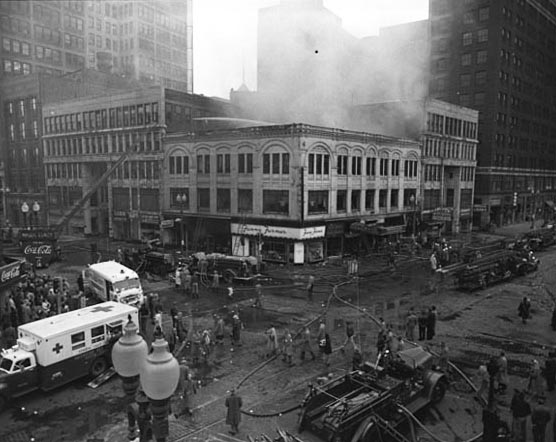
Hale Block fire – photo courtesy Minnesota Historical Society
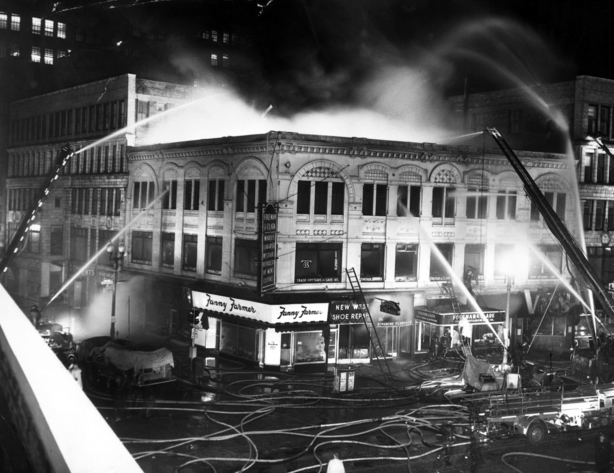
Hale Block fire – photo courtesy Minnesota Historical Society
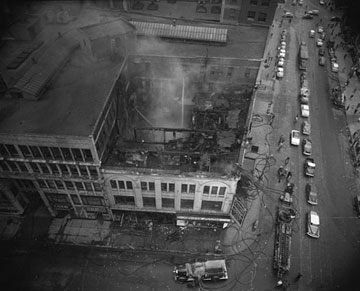
Hale Block fire – photo courtesy Minnesota Historical Society
THE NEW HALE BLOCK (It wasn’t called that anymore but I like the name)
On the day after the fire, city building inspector Donald Erickson ruled that the owners of the building would not be able to reconstruct it, although the outside walls were still standing, because more than 60 percent of the building was destroyed. (Minneapolis Star, October 26, 1954) The old building was demolished (wrecking permit January 25, 1955).
A building permit was approved to build a replacement building on April 25, 1955, in the same spot as the old one. The dimensions of this building were 83’ x 87’, and despite all those plans over the years to replace the Hale Block with a ten-story building, the replacement for the three-story structure was only two stories high. (It would have been three stories if NSP wanted the space.) The architect was Charles Hausler. This building stood on the corner for many years, anchored by Fannie Farmer.
The second Hale Building was demolished in 1986. The corner is now a parking lot.
Spring Park. In 1950 Ernie Lager provided Scandinavian food and entertainment.
The Log Cabin Bar was located at 4900 West Broadway in Robbinsdale.
ELLIS LOG CABIN
The first hit on the Strib database comes on June 25, 1926, advertising for an experienced waitress. The location is given as “one mile north of Robbinsdale.”
There was a long tradition of dining and dancing on this site, perhaps starting with a dance at the Ellis Log Cabin on December 4, 1926. Below are some ads for the 1920s and ’30s.
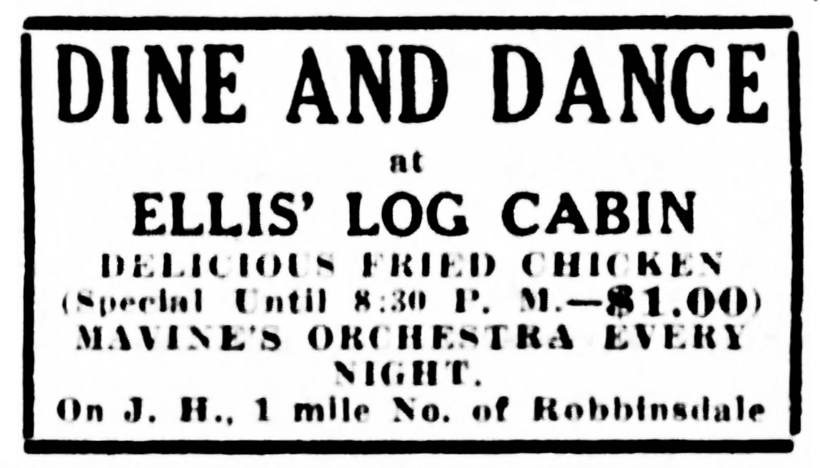
Minneapolis Tribune, May 30, 1927
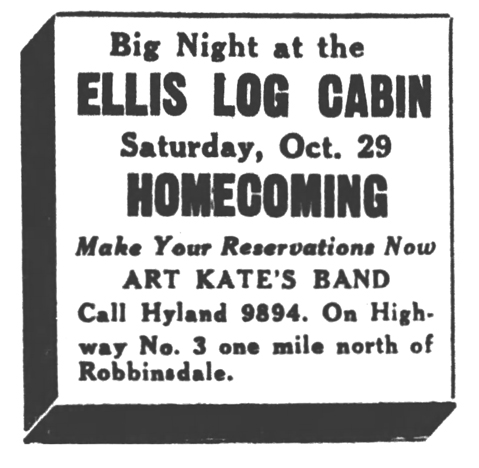
Minneapolis Tribune, October 1932
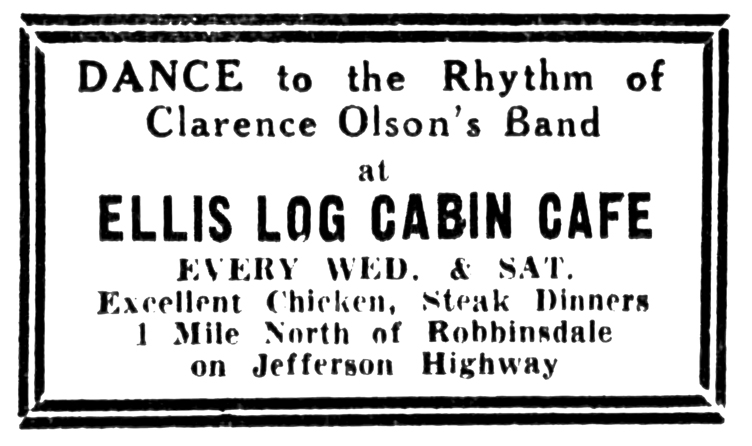
Minneapolis Tribune, April 4, 1934
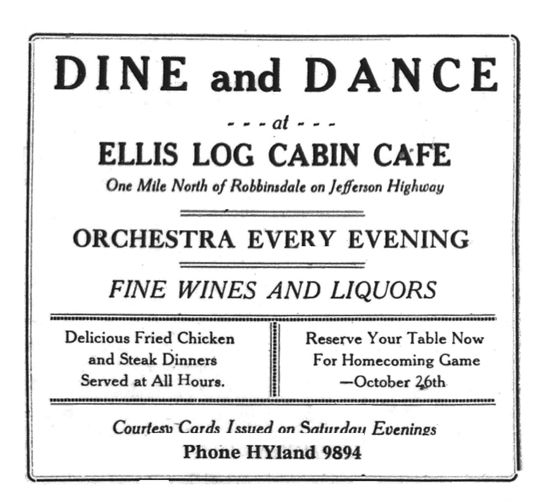
Ad from Hennepin County Enterprise – Robbinsdale, October 1935
At one time it was owned by William J. Schindler. On December 29, 1957, Schindler died.
LOG CABIN BAR AND CAFE
In November 1951, ads announced its new owners, “Happy” Hall and his son Bill. Dancing every Friday and Saturday with music by Wally Mohr’s Dance Band.
In June 1952 the entertainment was provided by Bill Zerban’s Orchestra.
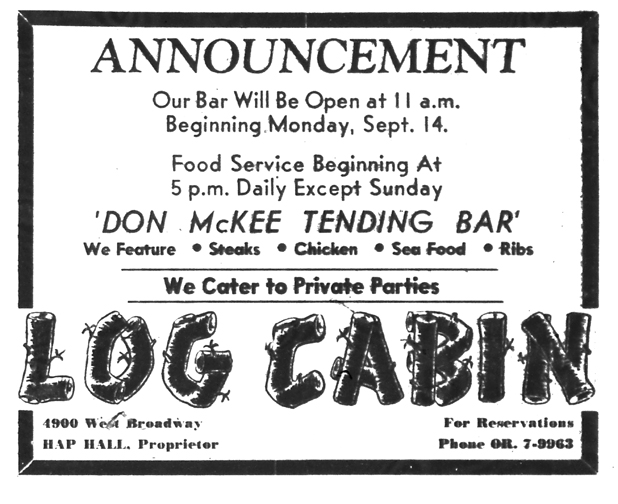
September 1953 ad, North Hennepin Press
Hap Hall advertised in the Minneapolis papers, Thanksgivings mostly, through 1954.
LOUIE’S LOG CABIN
The first ad for Louie’s Log Cabin in the Minneapolis papers was in November 1956.
According to the ad below, it was owned by Louie Paulsen, and there was dancing on Fridays and Saturdays.
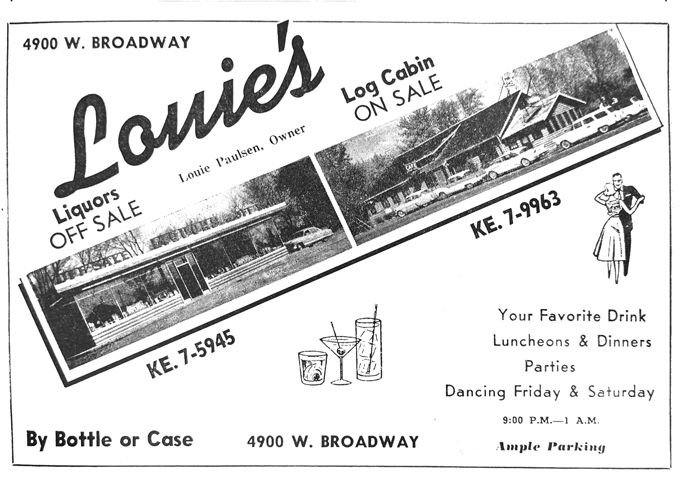
Courtesy Pete Ritchie, Robbinsdale Historical Society
LOG CABIN CAFE
By October 1962 the papers were referring to it as the Log Cabin Cafe. By January 1963 the Dancehall joined the rock ‘n’ roll era:
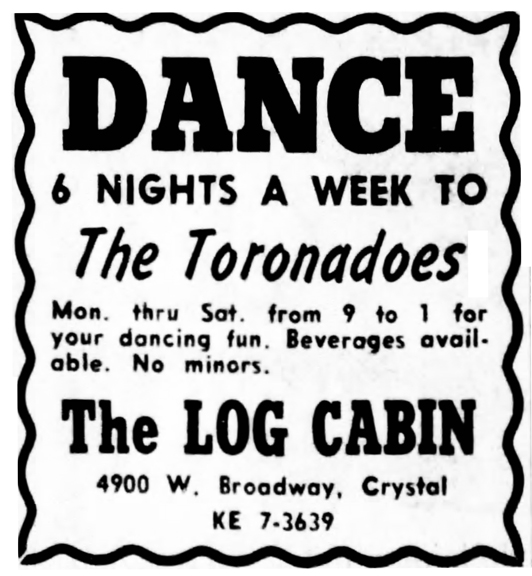
Minneapolis Star, January 17, 1963
In February 1963, the bar was named in a dram shop lawsuit when a customer, Alan Richardson, sued the Bar to collect $100,000 in damages after he left the bar and caused a five-car accident on December. The bar had sold alcohol to the driver of the car in which Richardson had been riding, David Allen Gould, 19. The bar’s owner was revealed to be Allan Rosskraft, age 24.
Perhaps as a result of the lawsuit, the contents of the bar were advertised for sale in June 1963.
CABIN BAR AND LOUNGE
But the Bar (and Lounge) continued – as evidenced by an article in the Minneapolis Star in March 1965 reporting that a check forging ring had been broken up at the Log Cabin Cafe and Lounge.
The bar was advertised for sale in November 1967. Ads for help were resumed in June 1968 for the Cabin Bar. The last one found was in October 1978. By that time it was featuring local rock bands.
CRYSTAL LOUNGE
From January 1979 until the end of 1984, it was the Crystal Lounge. [There was another Crystal Lounge, in the Bungalow Inn, at Highway 52 at Bass Lake Road in Crystal from about 1970 to 1972.] The bar offered rock bands, but there seemed to be a lot of police reports from the place. There was an arrest for gambling on November 8, 1984.
STEVE O’S SPORTS BAR
In January 1985 it became Steve O’s Sports Bar.
The Log Cabin Cafe may have been just that. Owned by Oren (Hap) W. Hall, it was at 4900 West Broadway in Robbinsdale in 1955.
The LoKates teen club was located at 3060 DeMontville Road in Lake Elmo.
It was run by Lowell Reiks. It was described as a new modernistic structure when it opened in 1968.
Thankfully, Ray Capocasa found a flier for the late, great Lokates! Given the dates on the schedule below, this must be from 1970.
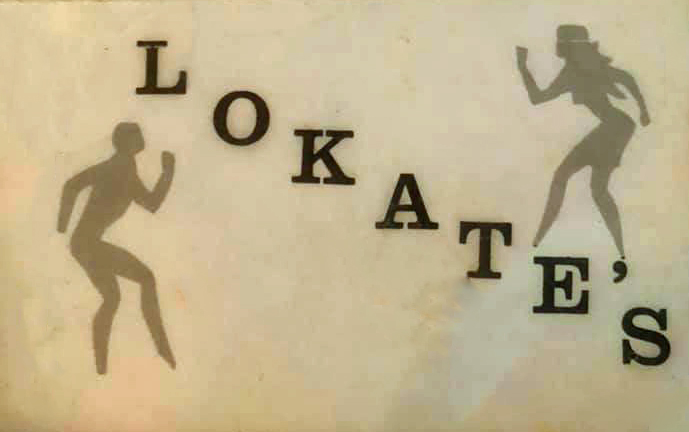
The flier came complete with a map!
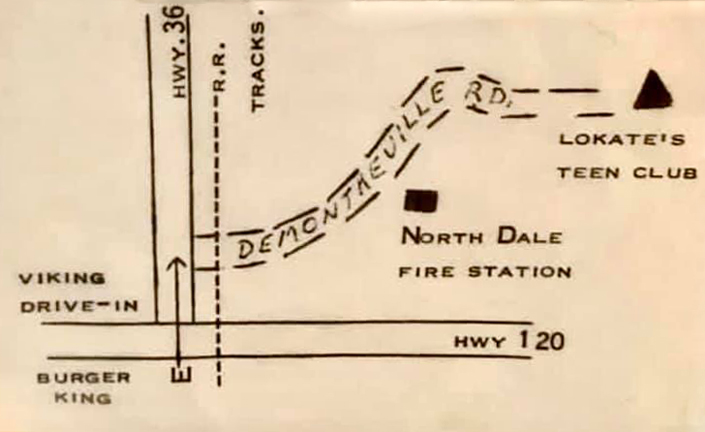
Image courtesy Ray Capocasa, with help from Jean Day
50 years later those former teens have great memories of dancing at Lokates! Roxie remembers a band named Mardi Gras that played there. Ray’s flier lists a schedule of popular bands:
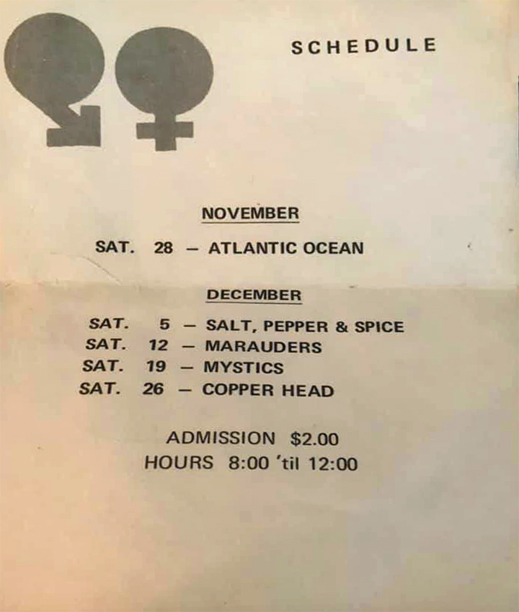
In 1970, when the teen market fell off, it closed on Fridays, along with the Barn and Magoos. High School dances were too much competition for clubs, said Connie’s Insider.
The Longhorn was located at 14 So. 5th Street in Minneapolis.
It was owned by Pat Blumenthal, who owned the Poodle.
The Music Room was a jazz spot that was part of the Longhorn – it opened on August 1, 1974.
Please see Mr. Lucky’s.
Louey’s was at 5001 W. 78th Street on the Bloomington strip in 1973.
It might have just been a restaurant, but here’s a placeholder.
St. Paul
The Lowry Hotel at 339 Wabasha Street was built in 1928. It had 10 stories. In 1973 the hotel was closed by its owner, Bob Short. Short wanted to make it into an office building, but that plan was kiboshed and he received approval to make it into apartments in 1977. It reopened as the Lowry Square Apartments.
Venues over the years have included:
TERRACE CAFE
Ben Pollack’s band made a lengthy appearance in the late 1920s. The photo below, from the Minnesota Historical Society, shows the Johnny Gilbert Orchestra performing a WCCO radio broadcast in 1940.
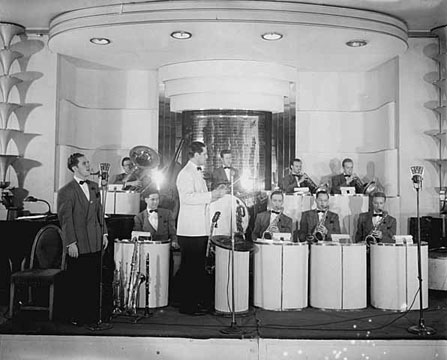
DRIFTWOOD ROOM
1963 – Musical Entertainment and Dancing.
HORATIO HORNBLOWER’S
This restaurant was on the main floor of the building. After closing on January 1, 1982, an electric light placed on a Christmas wreath caused a fire that had disastrous results. Witnesses heard three explosions, and fire and smoke filled the first floor. 80-90 tenants were in the building and had to be evacuated. One man died and many more were injured. Furnishings from the restaurant were auctioned off in January 1983.
OZ DISCO
The Oz Disco opened on Valentine’s Day, 1979, located at 345 Wabasha, in the lower level of the Lowry Hotel. It was owned by the Montpetit family, which owned several entertainment venues in Minnesota and Wisconsin.
FOLLOW THE YELLOW BRICK ROAD
As you might expect, Oz had a “Wizard of Oz” theme, complete with Yellow Brick Road and pictures from the movie along the hallway.
Brad Daniels offered up a photo of his Yellow Brick. He explained how he got it: “I was there at the Lowry to document progress during early stages of the renovation. The entire yellow brick road was in dumpsters waiting to be carted out.”
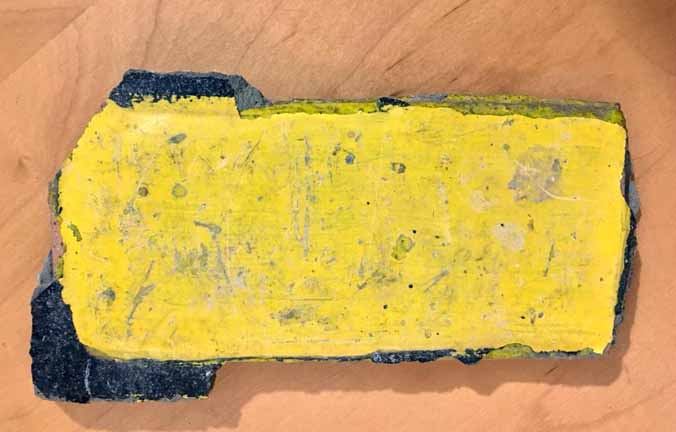
Image Courtesy Brad Daniels
Kathleen describes: “Lots of brass everywhere and mirrors. Beautiful and terrific music. Dinner upstairs at Horatio Hornblowers was wonderful. I miss both places.”
Gretchen remembers the three separate bars and the big bathroom with the couches and phones.
Brad’s memories are similar: “Brass, dark smoky mirrors and glass, garish dance floors lit from underneath.”
Nancy saw a guy there wearing a pair of boots that had real gold fish in the lucite heels! Might have been a fad; Lois still remembers the fishbowl coffee table (and the shag carpet).
LADIES’ NIGHT
Ann Marie saw the Chippendales there. Jill recalled that one guy’s stage name was “Kung Fu Dave.” Monica “used to go on Ladies Night for the strippers! 50 cent drinks or a buck. 1983, ’84. Men could get in at 9.” Lois noted, “Male dancers now are a lot more fit then the dancers in the 80’s.. just sayin!”
HUG A MUG
“You bought a plastic mug and drinks were free.” Beer, I hope.
FASHION
Myrna was a true Disco Queen:
Loved being part of the Oz disco scene. Especially since I had a great dance partner who had won a California State Dance Championship one year. He and I had some great Disco routines that were watched by many. Loved my Disco bell bottom outfits. He and I practiced a lot at the clubs two or three times a week because he wanted to enter some television disco competition (I forget what the name of it was). I wore a few pairs of shoes out but it was worth it. What fun memories. That lit up dance floor was a joy to dance on. One of the best.
Edward comments on male fashion: “Remember it well, fun place to be. Silk shirts, Angel Flite pants, platforms, gold chain, boom!” Michael adds, “Angel flight pants and silk shirts with two-tone shoes!” But Rolando also remembered the downside: “Dang silk shirts made you sweaty on the dance floor lol!” Kevin: “Good reason to wear my tan Brown leisure suit.” Someone mentioned Parachute pants – same as Angel flight pants?
SIGHTINGS
Scott “Saw my first mobile phone there. It was bigger than a shoe box and the base was carried with a shoulder strap.”
Several people mentioned Bill Cosby.
“First time meeting Prince was there.”
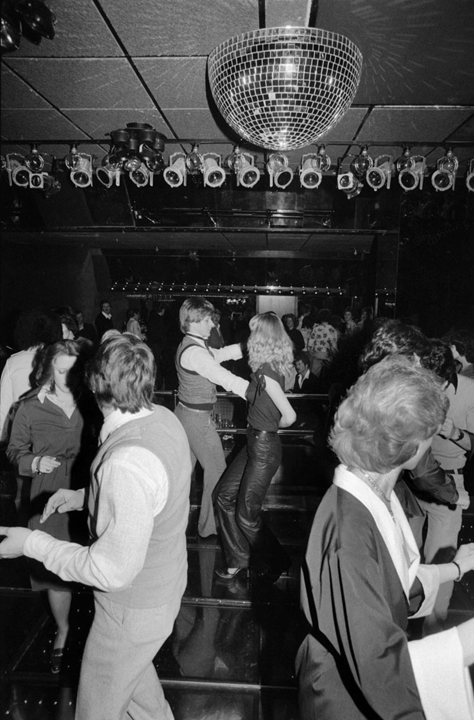
Photo Courtesy Minnesota Historical Society
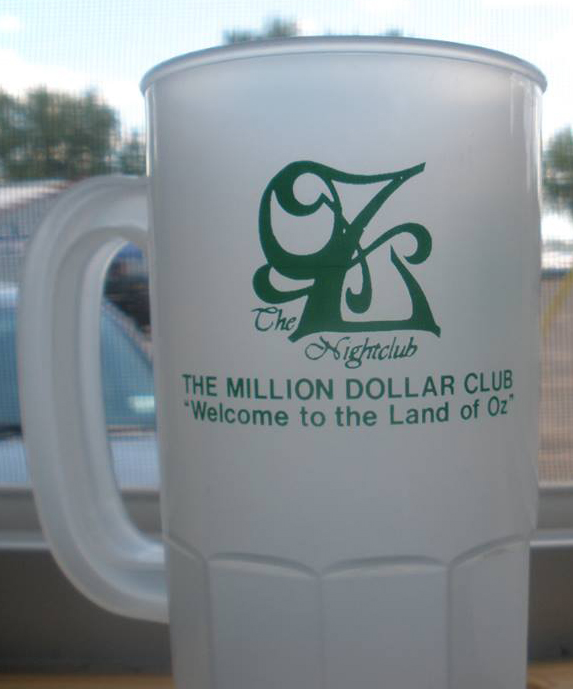
John T’s mug from “All you can Drink Night”
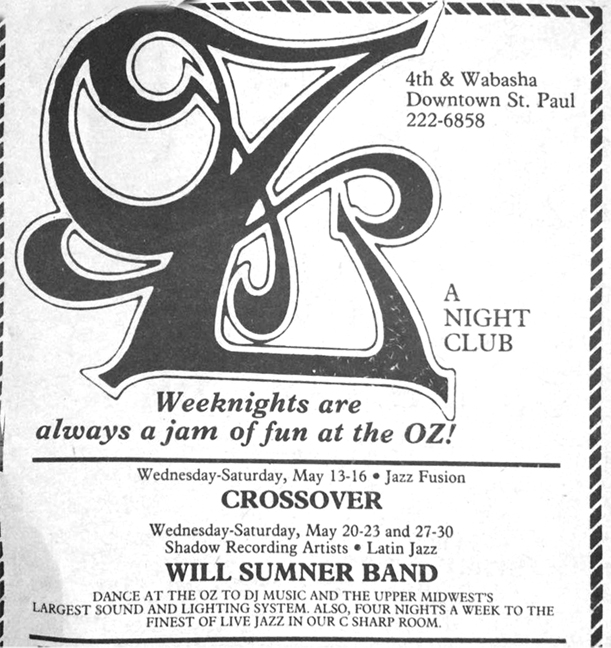
Ad from 1982 courtesy Sandra Kenyon
As a result of the January 1, 1982, fire at Horatio Hornblower’s, water pipes burst and flooded the dance floor at Oz below. Some dancers thought it was a special effect! The club was otherwise unharmed.
Oz shut down in about 1987, perhaps, and it became Sylvia’s on Cedar.
This page concerns three buildings:
- 718 Hennepin Ave.
- 711 Hennepin Ave.
- 85 So. 11th STREET (at Nicollet)
They are all together on this page because they have each had one of these theater names and other venues:
- Hennepin Avenue Theater
- Harris Theater
- Lyceum Theater
- Lyric Theater
- Blue Mouse Theater
- Skyway Theater
- Minneapolis Recreation
I know this is going to be confusing, but they kept moving names from one building to another, and this is the best I could do. I’ve named the page the Lyceum because of the confines of the web program, but hopefully a search will bring up the others.
I’ve also spelled each one “Theater” instead of “Theatre” to help with searching.
In their early days, these venues hosted plays, concerts, musical comedies, light opera, and live accompaniment to silent movies. Each of these venues no longer exist.
718 HENNEPIN (714-722)
HENNEPIN AVENUE THEATER: 1887 – 1889
This theater opened on September 19, 1887, with Booth and Barrett in “Julius Caesar.” The Gates Brothers were the builders and proprietors, and they leased it to Sackett and Wiggins to manage, the latter having been the proprietors of a successful dime museum for the last ten years. Minneapolis Tribune, December 1, 1907). It had seating for 1,692. Edgar described this theater as an “attractive East Indian playhouse near Seventh Street.”
By February 1888 the theater was deep in debt and its lawyer was facing jail for operating without a license. By March it was all over and the court ordered its principals to sell the theater at auction. Wrangling by the creditors kept the theater dark until Christmas, when it was opened for a few special performances. By then it needed work.
HARRIS THEATER: May 22, 1889 – August 1890
Impressario Pat Harris came in to try to put the theater to rights. But he killed himself. So that name didn’t last long. The new owners took suggestions for a new name. The theater was managed for a time by George H. Broadhurst, who later wrote “The Man of the Hour” and “Paid in Full.” (Minneapolis Music Report)
LYCEUM: August 1890 – 1908
In August 1890 the building was purchased by the Minneapolis Syndicate, and managed by J.F. Conklin. It was known as the Western home of light opera, and also presented lectures and concerts. In 1908 the Lyceum name ?? until 1924 when it was given to a refurbished Auditorium building at 85 So. 11th Street.
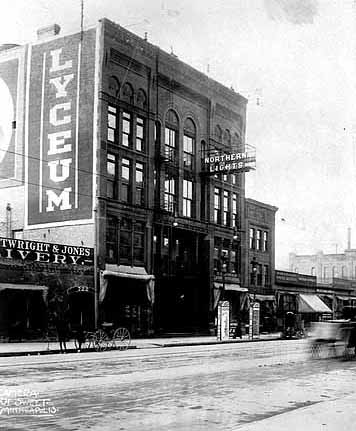
Lyceum Theater, 1905. Photo MNHS
LYRIC: 1908 – 1922
On September 21, 1908, the Lyceum was remodeled and renamed the Lyric Theater. The biggest theater sign in the city was erected, with 1,489 bulbs.
From 1912 to 1915 it was advertised in the papers as Saxe’s Lyric. Photos below courtesy Minnesota Historical Society.
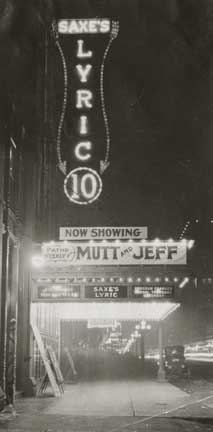
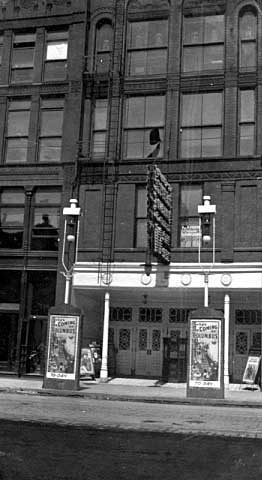
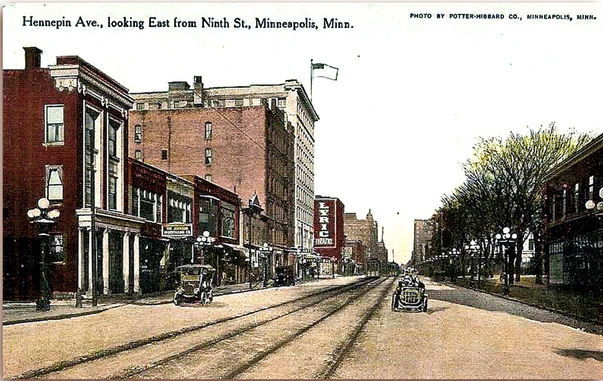
Cinema Treasures
The last play at the Lyric was “The Beggar’s Opera,” performed on February 9, 1922.
In 1923 the name of the of the theater was transferred across the street to 711 Hennepin Ave. (see below). Location was largely responsible for the Hennepin -Harrris-Lyceum-Lyric’s lack of popularity. It was almost necessary to carry a lantern to find the theater during its 20 years of its existence, and by the time Minneapolis had grown until its rialto included the property, the whole building was falling to pieces. (Edgar)
MINNEAPOLIS REC
On August 7, 1924, Samuel Sumner Snyder opened the Minneapolis Recreation Center opened in the shell of the old Lyric building. Only the side walls were retained.
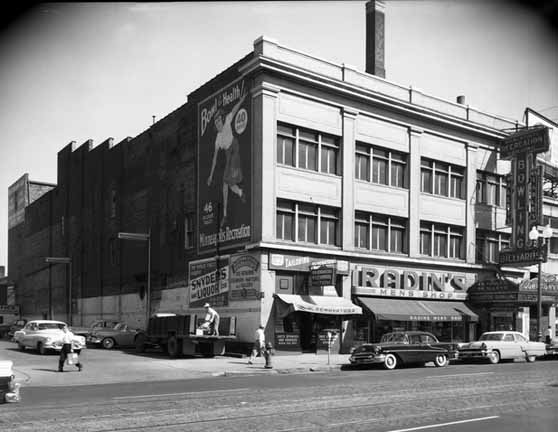
1955 Photo – Minnesota Historical Society
All four floors were dedicated to an amazing:
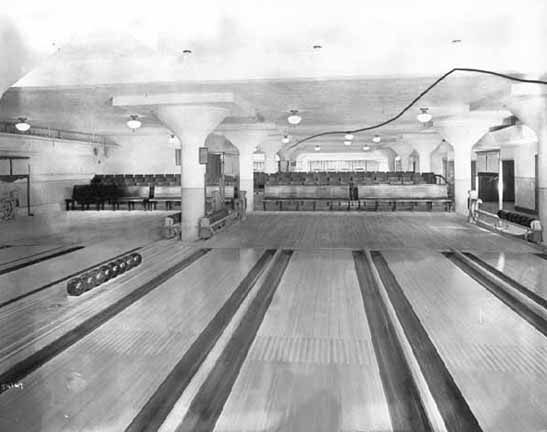
40 Bowling Lanes – 1924 Photo from MHS
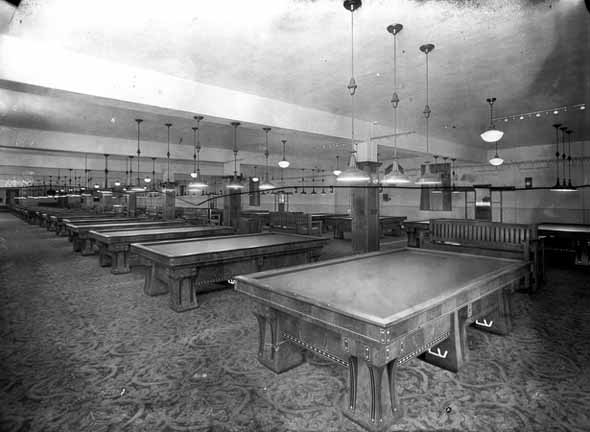
64 Pool and Billiard Tables – 1924 Photo from MHS
DEMOLITION
Snyder discontinued Minneapolis Rec in June 1959 when he could not negotiate a lease, and he died in 1960. There was an ad for Midtown Rec, which tried to open for bowling in the building in August 1959, but a permit for demolition was issued on December 29, 1960. The site is now a parking lot west of the Pantages Theater.
711 HENNEPIN
BLUE MOUSE: 1920 – 1923
From Bryan Krefft, Cinema Treasures.org:
The unusually-named Blue Mouse Theater opened in 1920 after more than a year of construction at a cost of around a quarter million dollars. This downtown Minneapolis house could seat around 1,500 in its elegantly decorated auditorium and contained a marble staircase in its lobby.
Its facade was decorated in white terra-cotta done in a Neo-Gothic style, and rose a full three stories over Hennepin Avenue.
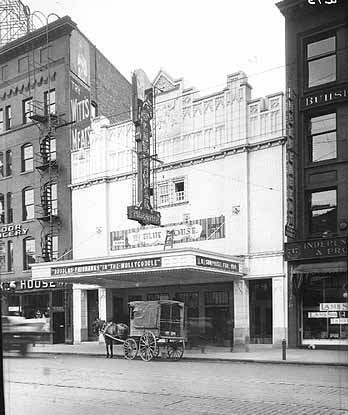
Blue Mouse, 1920. Photo Minn. Historical Society
LYRIC 1923 – 1970
The Blue Mouse was renamed the Lyric Theater on June 23, 1923, after the older theater of the same name directly across the street from the Blue Mouse Theater had closed.
For most of its existence, the Lyric Theater was a second-run house, playing films after they had had long runs as the larger houses like the Minnesota Theater or the State Theater, just up the street.
In the late 1950s, the Lyric Theater started to play roadshow films, with reserved seating, starting with the epic “The Ten Commandments” in 1957. This film, and a handful of others afterwards, would have decent runs, but only mediocre grosses compared to many other roadshow houses in the Twin Cities.
By the 1960s, it went back to second-run films.
On February 6, 1970, it was announced that the Lyric would be demolished and replaced by a new Lyric theater in the same location. It would also include:
- The area occupied by the El Morocco Bar at 725 Hennepin, which was demolished by September 1970, and
- The Lincoln Recreation Parlors at 721 Hennepin, which had been in business for 45 years, demolished in March 1969.
On April 24, 1970, the Lyric began screening the film “A Man Called Horse.” The American Indian Movement, led by Clyde Bellecourt, protested the movie, saying that the makers “totally humiliate and degrade an entire Indian nation, make sure all Indians are savage, cruel, and ignorant, make a white man become an Indian hero, and desecrate the Indian religion, among other things.” Especially galling was the casting of a former Miss Greece as the Indian princess.
About 100 people picketed the theater, and one woman was arrested for refusing to move on. Producer Sandy Howard actually came to Minneapolis to meet with the members of AIM and other protesters. Will Jones described the session as a standoff.
The last movie shown appears to be “Rio Lobo,” shown during the week of January 20, 1971.
SKYWAY THEATER
Originally to be called the Lyric Twin, ground was broken for this double theater/retail/office complex on May 15, 1971. Among those present was the obligatory set of twins and Miss Downtown.
The Skyway officially opened on October 3, 1972. One Facebook comment was:
The original 1 and 2 theaters were great. But number 3 down the hall [1975] and especially 4 on street level really sucked with their low ceilings and lousy sound and sightlines. When they split up the two original theaters to form 5 and 6, Skyway really went downhill.
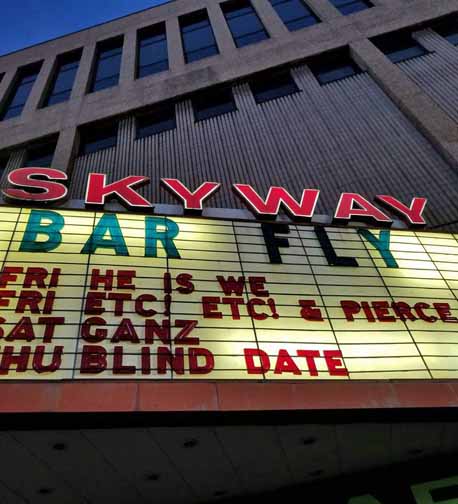
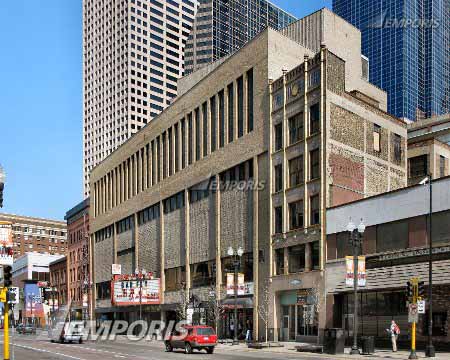
Skyway Theater, 2006
At some point the movie theaters were discontinued and turned into five music venues: Skyway Theater Main Room, Studio B, The Loft, and The Lyric, and Bar Fly.
85 So. 11th STREET (at Nicollet):
MINNEAPOLIS AUDITORIUM: 1905 – 1924
The Minneapolis Auditorium was built by the Northwest Life Insurance Co., and modeled after Symphony Hall in Boston.
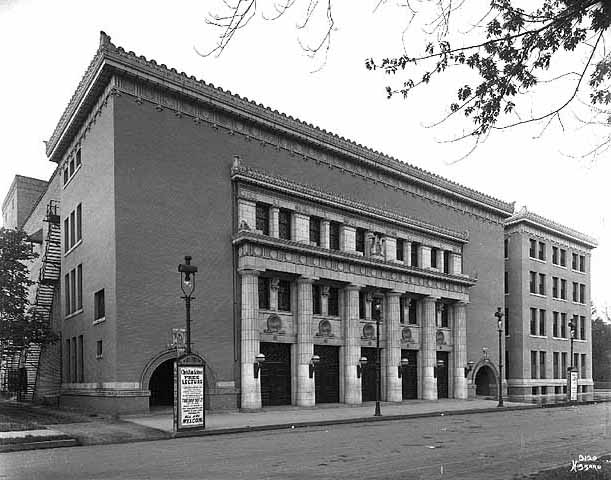
Minneapolis Auditorium, 1911-1913. Photo MHS
NEW LYCEUM: 1924 – 1958
The New Lyceum was a remodel of the old Auditorium. It opened on October 26, 1924. It featured a movie house with first-run features on the first floor, and a ballroom with a jazz orchestra for dancing on the second floor. The third floor had an additional dance floor and tea room, and the fourth floor had a “Little Theater” for rehearsals. The new Lyceum also became the home of the Minneapolis Symphony Orchestra, which began its Friday night series in 1903. The building operated as a theater for movies and legitimate theater until 1958, with Benjamin N. Berger as the lease holder for the last five years.
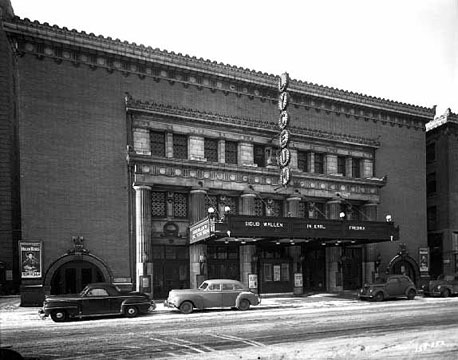
Lyceum Theater, 85 So. 11th, 1945. Photo MNHS
SOUL’S HARBOR
On August 15, 1958, the building was purchased by the Soul’s Harbor religious organization. Soul’s Harbor (Calvary Temple) first came to Minneapolis in February 1946 with nine members, but grew rapidly. By 1947 they had a church established at 5th Ave. and 10th Street So. Sermons were broadcast over radio stations WDGY and KEYD, and in February 1960 they became one of the first churches to have a regular television program, on WTCN-TV. The church planned to spend $75,000 to convert the building into a church, classrooms, and gymnasium.
In 1973 Soul’s Harbor moved to Regina High School in South Minneapolis temporarily.
ORCHESTRA HALL
On July 14, 1973, the building was razed to make way for Orchestra Hall.
Please see Lyceum Theater
This page covers the venues at 2609 – 26th Ave. So., in the “Hub of Hell,” (26th and 26th). They include:
- The Magic Bar
- Mr. Nib’s
- Mirage
- TNT
THE MAGIC BAR
In an undated, unsigned memo, the owner of the Magic Bar is identified as Minnie Ryan, but it is suspected that the deed was held by gangster Tommy Banks.
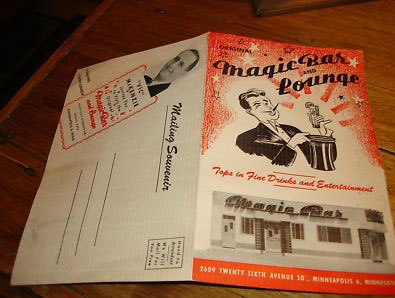
“Mailing Souvenir” (from Facebook) shows the front of the bar.
The three images below are from another “Mailing Souvenir,” generously donated by Chris Dysterheft! Thanks, Chris!!
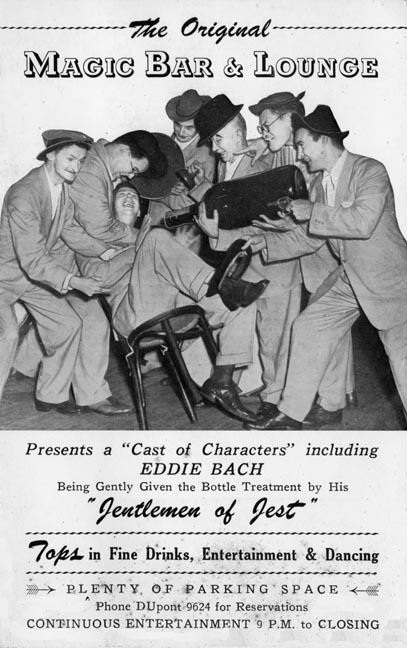
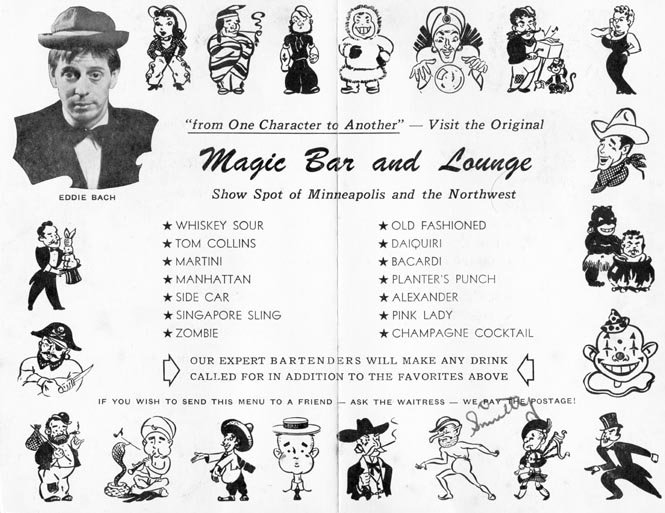
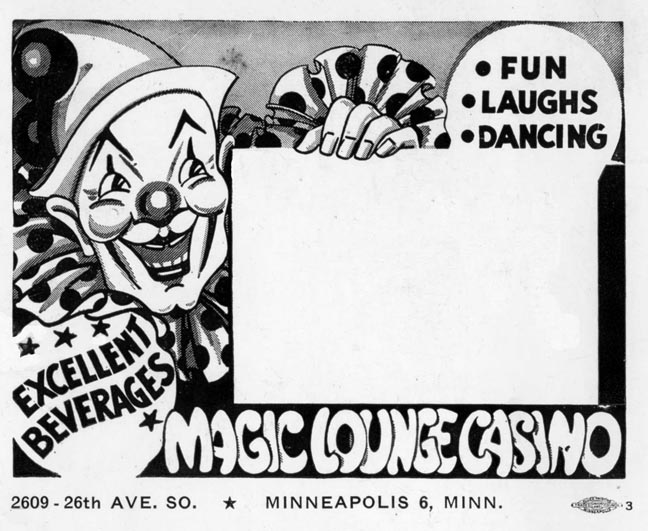
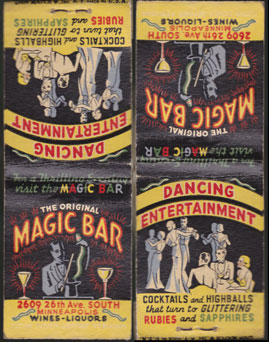
MR. NIBS’/NIBS’
NIBS’ BAR
For Mr. Nibs’ we have to back up to the end of Prohibition (April 1933), where we find Nibs Martin (Norbert Lowell Martin) running a neighborhood bar called Nibs at 35th and Cedar.
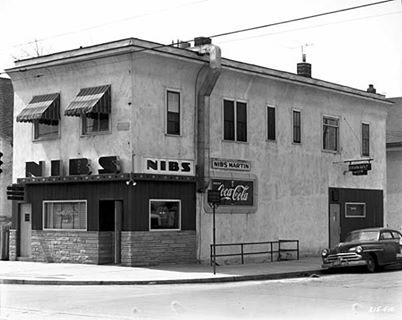
Not likely a music venue, just one of many places in the neighborhood to hang out. What made this place special was that, just before he left, Nibs invented a hamburger with the cheese on the inside that was so famous that President Obama dropped into what was now Matt’s Bar to try one in 2014.
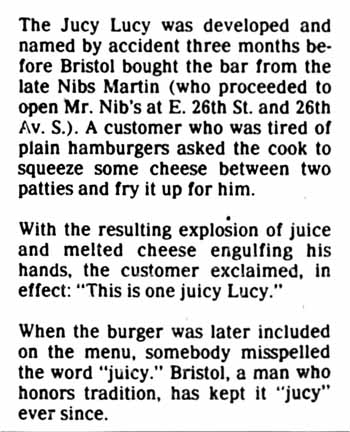
Dick Youngblood’s column, Minneapolis Tribune, September 3, 1984
In 1954, Nibs Martin sold Nibs Bar to Matt Bristol, and Nibs’ Bar became Matt’s Bar.
Meanwhile, Nibs was gradually changing the Magic Bar into Mr. Nibs. On June 2, 1960, Will Jones of the Tribune reported that first it retained the Magic Bar name. Then in July 1956 it was called Nibs’ Magic Bar.
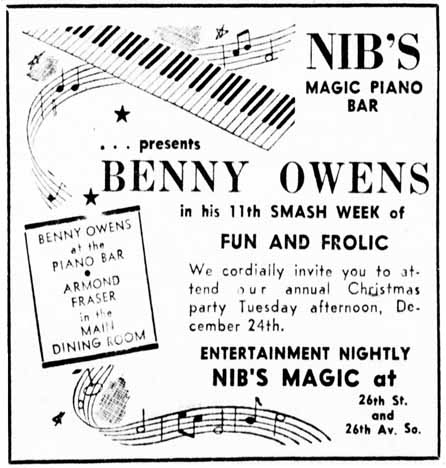
Minneapolis Tribune, December 23, 1957
Now, in June 1960, it was going all the way, and the sign was going up that said “Mr. Nibs’.”
On August 1, 1963, a large ad in the Tribune announced the “Big All New One in the Twin Cities, a wonderful new world of pleasure.” It was newly remodeled and renovated, with air conditioning. Entertainers in the ad were Patti Sherwood, the comedy team of Fraser & Nevers, and Jerry Vaughn.
In 1967 a band was Dave Major and the Minors.
1969: Parafunalia, the Swinging Ambassadors.
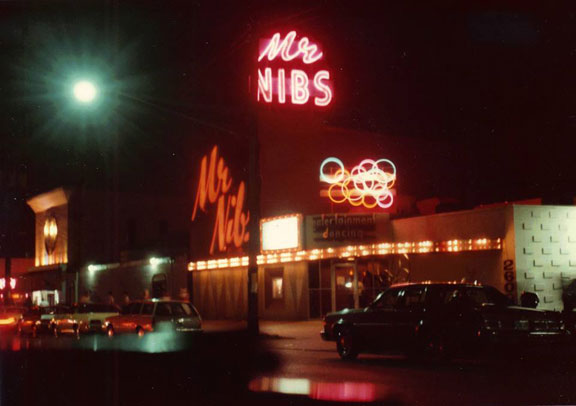
Photo courtesy Brian Carlson
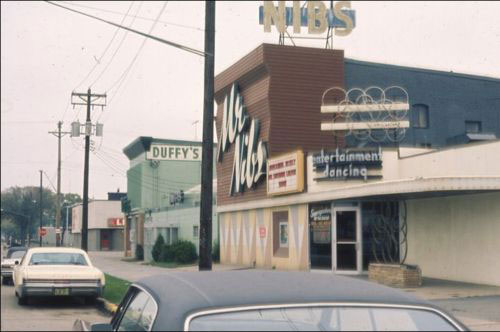
Photo courtesy Hennepin County Library Special Collections
Mr. Nibs became a country bar, featuring Sherwin Linton.
The building burned down on February 27, 1989. At the time it was owned by Gary and Darlene Stark. A band called Rockets Red Glare lost all of their equipment.
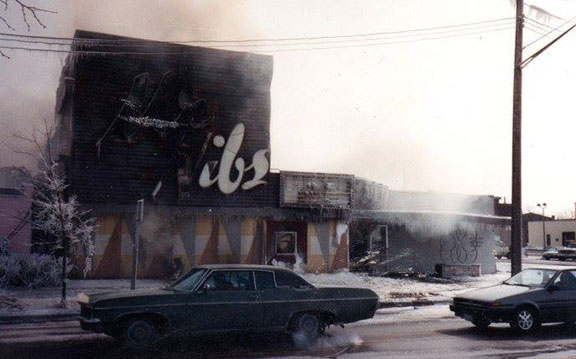
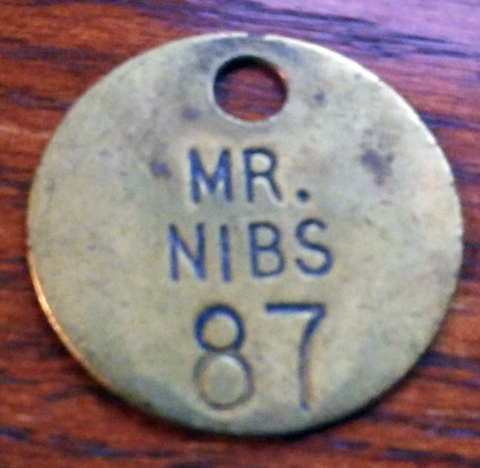
Bryan P. Bjornson salvaged this coatcheck token from the fire.
MIRAGE/TNT
The building was rebuilt as the Mirage Nightclub, which opened on October 28, 1989. Performers at the new club included Alvin Lee of Ten Years After and Loverboy.
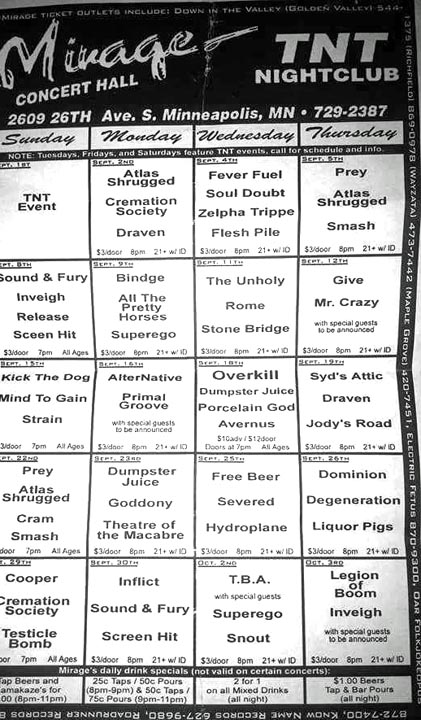
Posted by Lawrence Hurley on Old South Minneapolis Facebook page
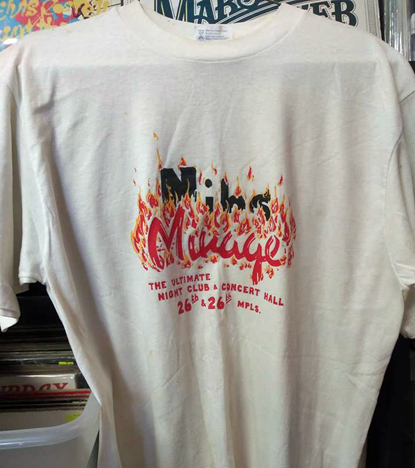
John Kass’s Mirage T-Shirt
The liquor license was revoked in April 1997 and the club closed.
NEW FRENCH BAKERY
The New French Bakery started in Uptown and expanded into this building in 1997.
Please see Mr. Lucky’s.
Cottage Grove
323 – 14th Ave. SE, Minneapolis. The January 1963 Select Twin Citian describes: “A jazz hideaway in the basement of the new Starlite Cafe in the University’s Dinkytown. Hot and cool jazz with the DS Trio every Friday and Saturday with occasional impromptu jam sessions featuring outstanding local jazz musicians, 9 pm to 1 am.”
531 W. 7th Street, St. Paul. Built in 1948 by Nick Mancini. His kids greatly enlarged the place with the hope of bringing in top notch entertainment, but it didn’t quite work out. But the place is still there, and Steve and I actually danced there recently – to one song. We’re getting old.
The Mandalay Club was at 347 E. 38th Street, Minneapolis.
This was where Irving Williams and his Rhythmaires, formerly the Wold-Chamberlain Navy Band, made their debut on February 2, 1946. The Club was apparently a restaurant, and the band performed in the Azure Room. The address is just across the street diagonally from Dreamland.
The Manor was located at 2550 W. 7th Street in St. Paul
1963: Musical Entertainment, piano bar, and dancing. Bob Pine was remembered as the pianist.
Jimmie Rodgers had an extended stay there in 1967.
1969: Norse Room.
1970: “Live big name entertainment seven nights a week in show lounge and dining room. Lounge with separate entertainment in another part of this huge supper club.”
In August 1974, Bea-Bea Benson was appearing at the Manor’s Rumpus Room. Associated with Kelly’s – same owner?
Here’s a drawing from 1984:
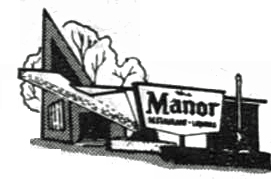
The Mantiki East was located at 1611 University near Snelling, the former site of the Heimbach Incinerator Company. We report these irrelevant things merely because we can.
Will Jones mentioned the Mantiki East in his column on January 22, 1964. The house band was a bluegrass group called the Country Briars.
Jones:
The decor of the Mantiki East is what might be called 3.2 Polynesian. There’s a suggestion of grass huts, low tables, and a section where customers sit on the floor at low Japanese-like tables.
On the night I went there, the room was packed, and everybody was reverently digging the authentic Kentucky-Tennessee-West Virginia sounds of the Country Briars, and their funny-hat routines as well.
The room is a fairly exact copy, I am told, of a room in San Diego, Calif., the Mantiki West, where the same formula has been successful: bluegrass music among brown grass huts.
Fortunately, I was contacted by Mike Appleton, who gave me the history of the venue. It was owned by his parents, Tom and Marcia Appleton.
My parents were both from St. Paul and lived out in San Diego in the very early ’60s because of my dad’s work. Out there, they fell in love with a bar called the Mantiki, spending too much of their time and money there. When my dad’s job moved him back to Minnesota in 1963, they decided to open up a St. Paul version of the bar and call it the Mantiki East.
The bar actually opened in November of 1963. The grand opening was November 22, 1963. The date they chose may have been a portent for things to come… I know that good times were had, but the bar eventually became too difficult and too expensive for my parents to run, so they subsequently sold it in 1965. The building was heavily damaged by fire that same year [December 6, 1965], and it was never reopened.
Thanks, Mike!
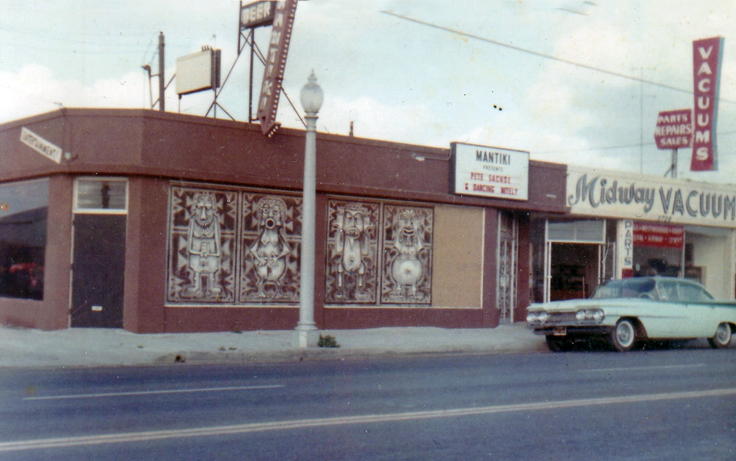
Image courtesy Mike Appleton
Matchbook images below courtesy Mike Appleton
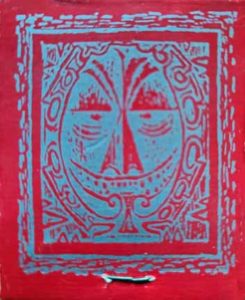
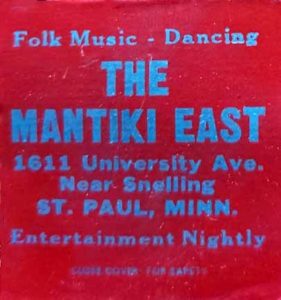
Maple Lake Pavillion was across from Maple Lake on Hwy 55 in Maple Lake, Minn. Owned and operated by Kay Schue. It’s now Maple Lake Antiques.
White Bear Ave. and Larpenteur, Maplewood. Not sure if this had music, but Mark Youngblood has this cool ashtray. Formerly Garrity’s.
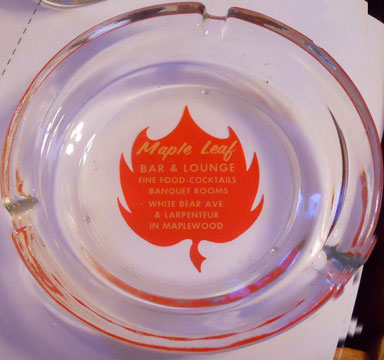
The Maple Leaf Club was one of many tenants of 128 Highland Ave. Please see the Harlem Breakfast Club.
Mar-Thel’s Lounge was located at 110 W. 98th Street in Bloomington. It was started by Marv and Thelma Pahl in October 1956.
Not sure to what extent music was an integral part of this establishment, but:
- There was a dance floor, and
- In 1963 Marv advertised for a pianist to lead singalongs.
In 1969, the Mar-Thel’s softball team won the State Championship and competed in the regionals. In 1970 the team was taken over by George’s in the Park.
In 1963-63 Marv was in a pickle when he tried to get a liquor license, newly-available in Bloomington. City ordinance said that his bar would have to be at least 1,000 ft. from a school, and his establishment was only 500 feet from a new school. He was allowed to continue letting his customers bring their own liquor and spike their drinks, however.
In 1975 it was advertised as Mar-Thel’s Pizza Pit.
The Pahls retired and sold the place in 1979. Thelma died in November 1994.
The corner of 98th and Nicollet is now a Holiday gas station, built in 2002.
The Marian Ballroom was on 79th Street and Dupont in Bloomington. We set out to find it, but there was no 79th Street and no ballroom to be found. Then it hit me – that old Knights of Columbus Hall just might have been the Marian Ballroom years ago. I stuck my head in and asked, and Bingo! (Which is what they were playing at the time.)
Turned out it was the Marian Chapter of the K of C, and they rented out their ballroom to different groups for dances – still do! Back in the early-to-mid ‘sixties, someone organized teen dances featuring local groups like the Underbeats, the Del Counts, the High Spirits, and who knows – maybe even the Trashmen. On other nights, Willie Peterson had the house band, playing music for our parents.
Back many decades ago, my husband somehow made his way to Bloomington from Edina before he could drive to dance the night away. But the music died – at least for teens – he remembers, when the boys started fighting. The last straw was when Cary Tarbox, a tough guy from Richfield, broke a cop’s jaw in four places. We looked up Cary on Ancestry.com – he went to Vietnam, came back, and died at age 30.
Anyway, here are some pictures from our trip to the Marian in June 2017. Steve says the ballroom is a total time capsule, exactly the same as it was when it was built in 1957. (The building itself is different – an addition was built on the east side and a second floor built since then.) It’s now also called the Bloomington Events Center, and 79th Street is now American Blvd., but inside, it’s the Marian Ballroom.
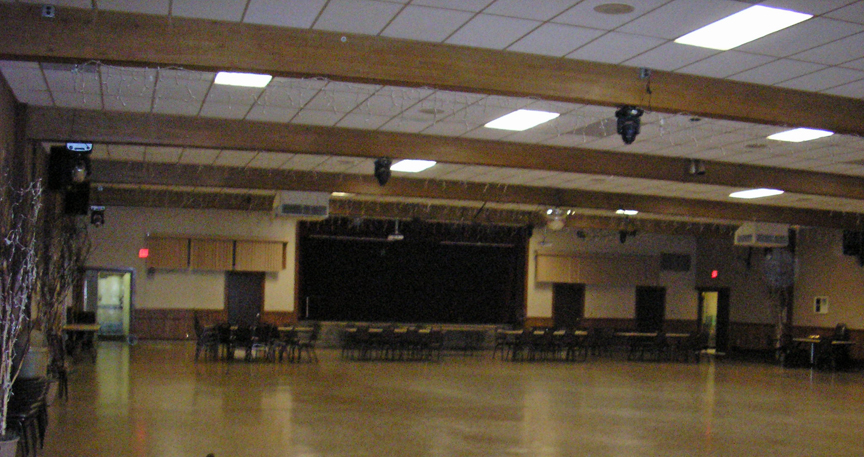
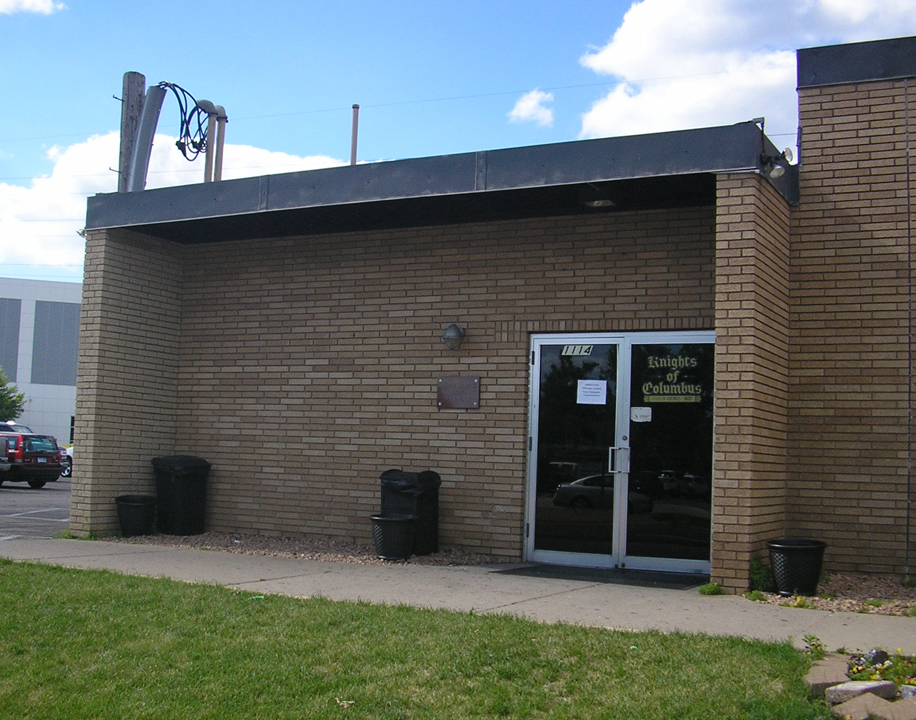
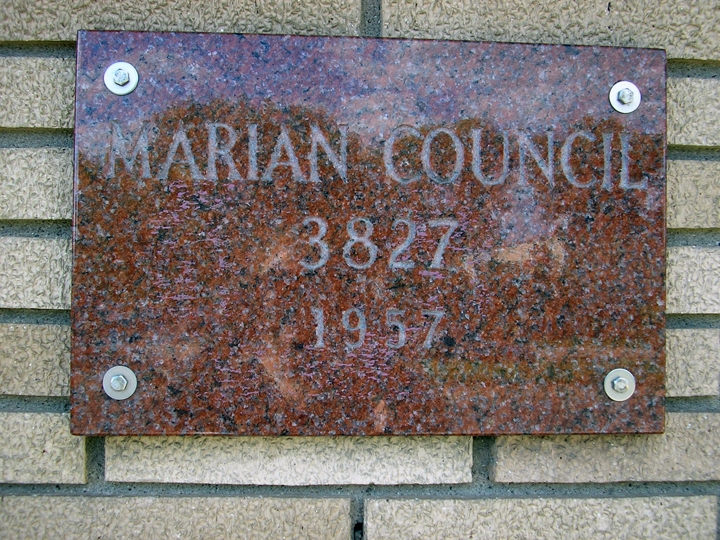
Save
The Marigold Ballroom was located at 1336 Nicollet Ave. in Minneapolis. (1330-1342 Nicollet according to City permit cards.) Its boundaries were Grant Street W on the South, Nicollet on the East, LaSalle on the West, and 13th Street on the North. 13th Street has vanished in its current configuration. One parcel is now identified separately as 14 Grant Street, but the permit cards lump it all together as 1330-1342 Nicollet.
It also appears that the building did not go all the way to Grant Street, at least on the Nicollet side. There is a strange looking building there in the 1936 photo below, and a burger joint in the 1950 photo. This may be 22 Grant Street, which is still a separate parcel.
It appears that the first permit was taken out on November 1, 1911. An article says that the building originally housed the Laybourne Auto Company and several retail stores. I couldn’t find the auto dealer, but there was a bakery in 1917, which was advertised for sale in October 1924.
More ads and information to come.
MARIGOLD GARDEN/GARDENS
The ballroom opened on November 24, 1923, as the Marigold Garden, described in ads as located at Grant at Nicollet. The name morphed over time, sometimes known as the Marigold Gardens Ballroom, before settling on Marigold Ballroom
In September 1924 the ballroom was sold, and the managers went to court to restrain the new owners from interfering in the operation of the facility.
Permit cards show work altering a store to a Mortuary in the building, October 10, 1924. The cost was a high $1,000.
On November 29, 1924, the Yellow Cab Co. hosted 500 Minneapolis orphans to a meal at the Marigold, a show of Vaudeville, a parade and tour of the city. 500 orphans.
By December 1924 the name appears to have settled on Marigold Ballroom (albeit spelled Ball Room), and identified no longer at Nicollet and Grant but at 13th and Nicollet.
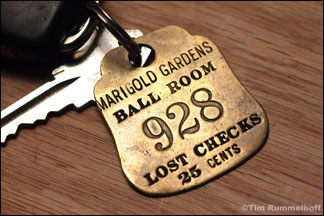
Image courtesy Tim Rummelhoff
On February 22, 1925, the first broadcast of radio station WAMD emanated from the Marigold Garden. The station broadcast all music, and its call letters stood for “Where All Minneapolis Dances.” Broadcasts were initially on Sundays from 2:15 to 5, and continued until the end of July 1925 when the station moved to the Radisson Hotel. WAMD became KSTP in 1928.
Permits indicate that there was a fire on October 28, 1925, but all that was in the paper was an ad to come and see Charleston dancers.
Then, after June 1926, a pause.
THE NEW MARIGOLD BALLROOM
The New Marigold Ballroom opened on September 6, 1926, with a splash – and a rare full-page ad in the Minneapolis Daily Star on September 4. An article in the same paper explained how the ballroom started out small, and then acquired one business after another in the building to expand to meet demand. In September 1926, the ballroom’s footprint was a “half block deep, quarter block wide” at Nicollet and Grant. It was at this time that another $100,000 was put into the property to expand it further, with 32,000 square feet. A ladies lounge and special cosmetics room were added, and the men’s smoking room and lounge were moved to the basement so they could be expanded. Employees were to be dressed in evening dress. There were two orchestras. The checkroom accommodated 3,600 coats. Girls had to be 18 to enter, boys had to be 21. (Girls mature so much faster than boys…)
The great Fletcher Henderson brought his famous swing band to the Marigold Ballroom on April 20, 1937. The show was called a “white dance” by the Minneapolis Spokesman. The night before, Henderson performed at the Coliseum Ballroom in St. Paul, “the first time in 12 years that the colored people have had an opportunity to dance to the strains of a nationally known orchestra.” The Spokesman reported that almost 15,000 people attended the dance, the largest dance crowd assembled in the Twin Cities in 20 years.
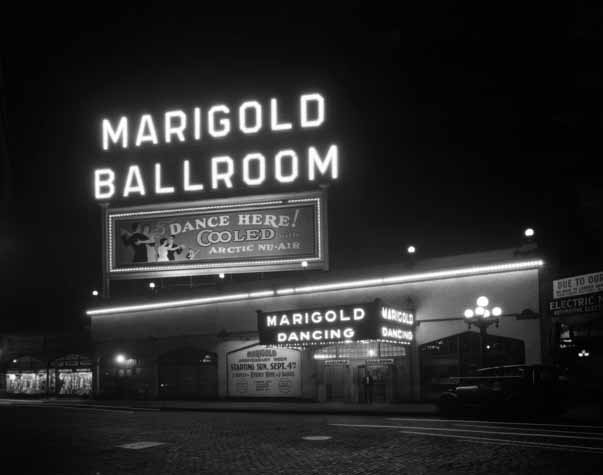
Marigold Ballroom, 1930. Photo Minnesota Historical Society
The New Orleans’ Rhythm Kings appeared in the late 1920s, as well as local groups like Eddie Corlew’s and Steamboat Smith’s bands. The Marigold Entertainers were featured until about 1929.
THE NEW NEW MARIGOLD
Further refinements and enlargements were made in 1929, with a grand opening on August 31.
The ballroom’s motto was, “Never Grow Old Dancing at the Marigold.” There was a sign to that effect in the ballroom, and it showed up on ads in 1959.
1950 REHAB
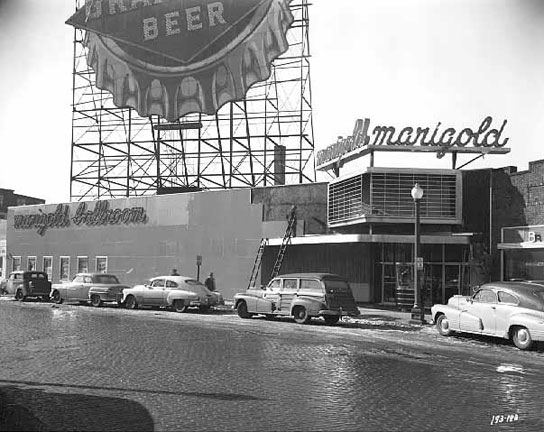
Photo from February 1950 Courtesy Minnesota Historical Society
Permit records indicated something about a bowling alley in December 1940, but maybe it was just sharing the building with the ballroom.
On March 5, 1941, an electrical fire that started in the ballroom’s control room in the basement sent sparks flying up the wires and out to the electrical poles, shutting off the electricity for the ballroom and the neighborhood. The Tribune reported minimal damage.
Elmer A. Larson became the manager of the ballroom, and bought it in 1972.
A Gala Shrine Frolic with Preston Love and His Orchestra (“The Happy Boy With the Horn”), appeared at the Marigold Ballroom on January 30, 1956.
On May 24, 1956, Woody Herman’s Third Herd played at the venue to celebrate its 40th anniversary; it was the first name band to play there since Paul Whiteman in 1930.
Country singer Hank Thompson appeared at the Marigold Ballroom on August 13, 1956.
Duke Ellington and His Famous Orchestra appeared at the Marigold Ballroom on November 6, 1957.
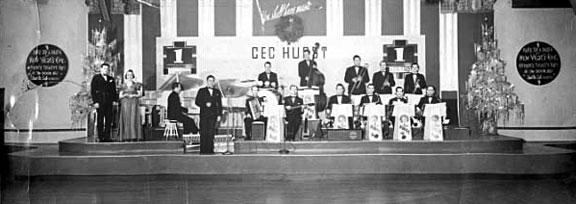
This MHS photo from 1958 of the Cec Hurst Orchestra shows how big the stage was.
In March 1958 WLOL hosted the Royal Crown Cola Bandstand at the Marigold Ballroom, with DJs Dan Anderson and Don Dahl, Sunday afternoons from 2 to 5pm. Admission was 50 cents and open to teens age 16 and over. “It’s the swinginest!”
1962 ad: “The New Marigold Ballroom – Minneapolis’s Smartest and Largest.”
A national dance contest was sponsored by the American Federation of Musicans to find the best new dance band of the year. On March 16, 1959, the local contest, sponsored by the Minneapolis Musicians’ Association, took place at the Marigold Ballroom. Each band would play four numbers. The winner would compete in a regional contest in Des Moines; a semi-final in Chicago; and the final in New York. The winner was promised a recording contract with Decca records, a national TV appearance, all new instruments, and weeks of bookings at ballrooms all over the country. Entry was free, bands could not have more than 15 pieces, and the music had to be “modern dance music.” “(Other contests for rock ‘n’ roll, hillbilly, western, old time, Dixieland, or be-bop may be held later.)” Bands would be judged on showmanship (appearance and presence); tone quality; rhythm; and musical arrangements.
B.B. King appeared at a Mother’s Day Matinee Dance at the Marigold Ballroom on May 10, 1959, presented by the Horsemen.
Willie Mabon appeared at the Marigold Ballroom for a Sunday Matinee dance on June 14, 1959. It was billed as a “Wash and Wear Affair,” promoted by The Horsemen.
Bobby Bland appeared at the Marigold Ballroom on July 26, 1959.
The Shrine Gala Day at the Marigold Ballroom was on September 25, 1959, 9 pm “til unconscious.” Music was provided by Hank Hazlett and His Band.
Roy Milton’s band, featuring Mickey Champion, blues and ballad singer, appeared at the Marigold on March 12, 1961. They had been appearing at the Key Club since January 19, 1961.
Brook Benton, with the Milt Buckner Orchestra, appeared on April 14, 1961.
Joe Williams, formerly with Count Basie, appeared at the Marigold Ballroom on June 16, 1961.
1962
On January 5, 1962, dance instructor David La Vay held an all-city “Twist” Night at the Marigold Ballroom featuring that perennial rock ‘n’ roll group, Mike Waggoner and the Bops.
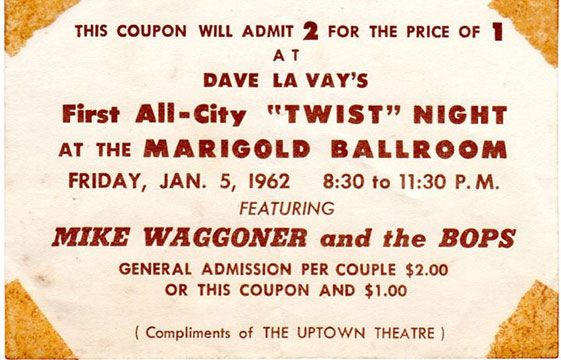
Twist to Johnny and the Galaxies on February 2, 1962. This may not have been a local band.
The Corvets provided the music for a “Rock-Roll N’ Twist Hop” on February 23, 1962.
Bill Diehl appeared with Mike Waggoner and the Bops on March 2, 1962.
Bill Diehl was back on March 23, 1962, hosting a Battle of the Bands. Who won? The Diablos or the Corvets? Both were very early, hardworking bands.
DJ Hal Murray hosted the Diablos at a teen dance on April 6, 1962.
Dickey Lee played the Marigold Ballroom on December 26, 1962. Bill Diehl was there as emcee.
1963
Mike Waggoner and the Bops played for the teens on January 2, 1963.
March 22, 1963, promised an all-star Teen Hop with Mike Waggoner and the Bops and the Dorados.
In August 1963 the ballroom was air conditioned. Many of the dances featured old time bands and/or specified different age limitations for different nights. Some were over 21, some over 25, some over 28. Dances were NEVER for people over 30, though, because women didn’t want to admit they were of that certain age!
1964
Bill Diehl appeared with Mike Waggoner and the Bops on March 20, 1964.
The Marigold Ballroom was the site of many acts that R&B station KUXL brought in, hosted by DJ Preacher Paul. Bobby “Blue” Bland might have been the first KUXL show, appearing on July 22, 1964.
Bo Diddley got the Marigold going on August 19, 1964. It was the same night Count Basie was at the Prom, and a conflict was feared, but Will Jones reported that Mr. Diddley drew 1,500 “sweating youngsters, ” and the Count drew 1,350 “oldsters.” (Minneapolis Tribune, August 21, 1964)
The Tams made an appearance on August 23, 1964.
Bobby Freeman, who did “Let’s Do the Swim,” came to the Marigold on September 27, 1964.
On November 6, 1964, national group the Hondells went head-to-head with local heroes the Gestures from Mankato.
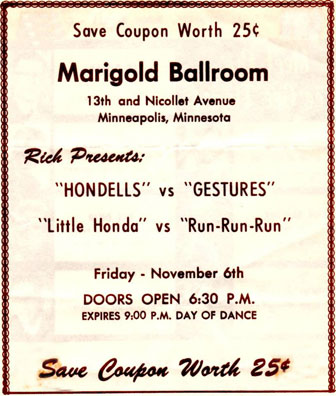
Image courtesy Dale Menten of the Gestures
1965
An epic blizzard prevented Bobby “Blue” Bland from making a KUXL-sponsored dance in March 1965, but a local musician was found to substitute, admission price lowered, and the event still drew 2,600 people.
The Impressions made an appearance at the Marigold on April 11, 1965.
THE MIDWEST AU-GO-GO
Midwest Au-Go-Go was held on June 4, 1965, at the Marigold. On the bill were the three biggest local bands in town:
- Gregory Dee and the Avanties
- The “Wild” Accents
- The “Stompin'” Underbeats
Now the flier doesn’t give the year of this blowout. You can cheat and look to see what year April 4 falls on a Friday, but that’s really not necessary, since 1965 was the year of the “Au-Go-Go.” Were you a “Hip Swingin’ Au-Go-Go Dancer? Sigh.
I apologize that I do not know the origin of this flyer – I probably grabbed if off of Facebook. If it is yours, please contact me so I can give you credit.
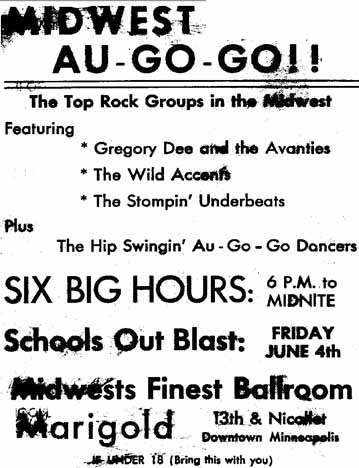
UPBEAT!
“Hey! It’s Upbeat! Dance every Friday nite at the Marigold Ballroom to top local and national groups.” Former disk jockey Dino Day (aka George Murphy) taped the show here to be shown on Sundays on Channel 9. The show premiered on August 1, 1965. See TV Shows.
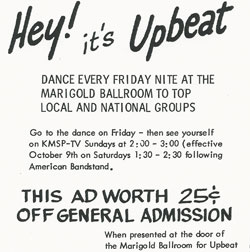
KUXL sponsored an appearance by Ike and Tina Turner at the Marigold on August 1, 1965. The appearance brought 5,000 fans.
The Trashmen came to the Marigold on August 20, 1965.
On August 23, 1965, a fracas broke out involving 400-500 young people throwing eggs and rocks at cars, about a block from the Ballroom. Except that police reported that the incident only involved “several” youths. (And where would they get eggs?) One 20-year-old was arrested. Half an hour later, police were called to break up the crowd of 200 who had gathered outside the Ballroom when an “unidentified youth discharged a fountain pen tear gas gun. Police said they did not use tear gas to break up the crowd.” (Minneapolis Tribune, August 25, 1965)
BB King performed at the Marigold on September 12, 1965. The announcement was in small print in an ad for another show.
1966
Jackie Wilson was scheduled to perform at the Marigold on January 14, 1966, but didn’t arrive until midnight, causing a “near-riot” at the ballroom when the 1,600 people in the audience “became annoyed.” Police were called and the City Council discussed the matter. (Minneapolis Tribune, January 27, 1966)
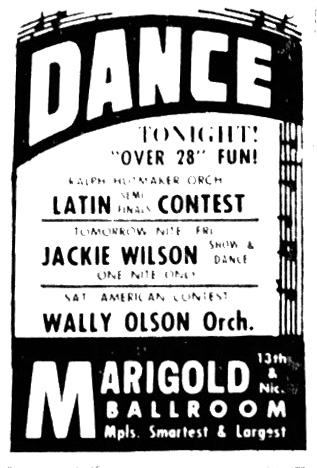
Rufus Thomas appeared with local group the Amazers on June 24, 1966.
Pam Schmitz found this fabulous poster, advertising a six-hour marathon of the Cities’ favorite bands, playing at the Marigold Ballroom on September 9, 1966.
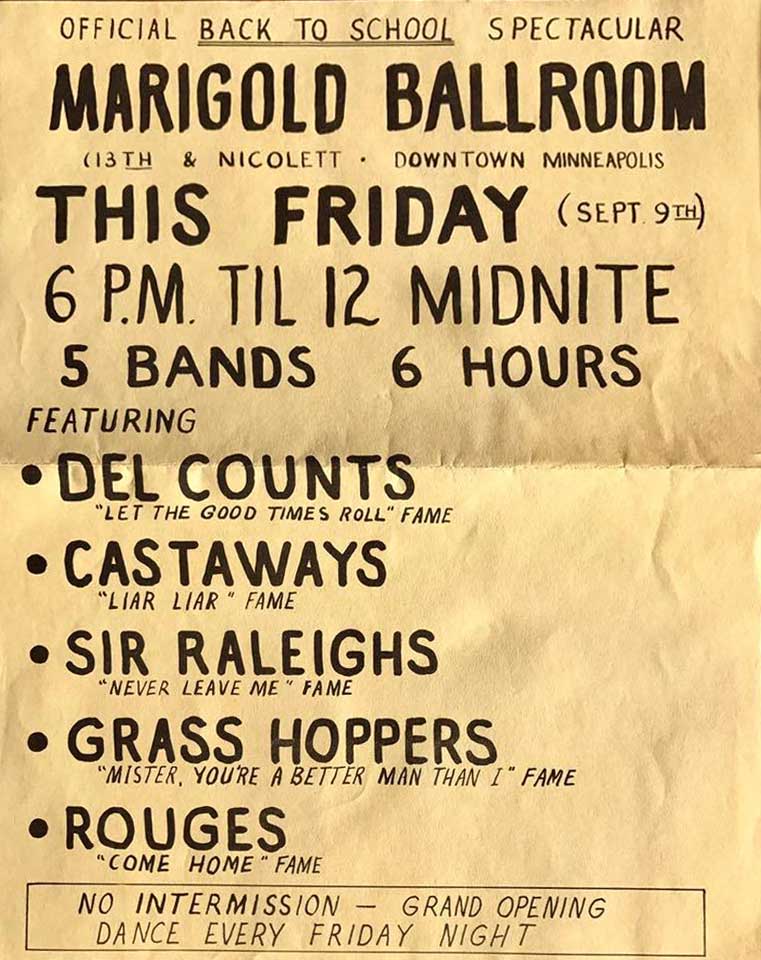
Image courtesy Pam Schmitz
The Temptations came to the Marigold on October 16, 1966, and police had to be called when 800 to 1,000 people on the sidewalk got impatient waiting to buy tickets at the one ticket booth. Police shut down Nicollet Ave. and were heckled by the crowd. The glass in the ticket booth was broken in two places, but Ballroom manager Elmer Larson insisted that there was no danger of the crowd getting out of hand and that the booth broke because it was “poorly constructed.” One person was sought for breach of the peace. (Minneapolis Star, October 18, 1966) Interestingly, the name of the act was never mentioned in the news reports.
1967
KUXL hosted the Impressions at the Marigold Ballroom on January 22, 1967. Also appearing were the Amazers.
The Del Counts held a record release dance on March 17, 1967.
The Byrds performed at the Marigold Ballroom (and also in Mankato), perhaps on November 10, 1967.
Harvey Scales and the Seven Sounds, in town for a gig at King Solomon’s Mines, performed on October 27, 1967, at the Marigold.
Other acts included: (This list may have come from the Insider.)
- Solomon Burke
- Chuck Jackson
- Fats Domino
- Little Milton
- Junior Walker and the All-Stars
- The Four Tops
1973
Bonnie Raitt was the first of a series of performers booked into the Marigold Ballroom by Owen Husney of Owen Productions. She did two shows on October 14, 1973, opened by Keith Follese and Willie and the Bumblebees. The otherwise old time/polka/big band venue began a policy of hosting rock acts.
1974
January 18, 1974: Melissa Manchester, Danny O’Keefe, and introducing (Jim) Muske and (Nick) Raths. Show promoted by Owen Husney.
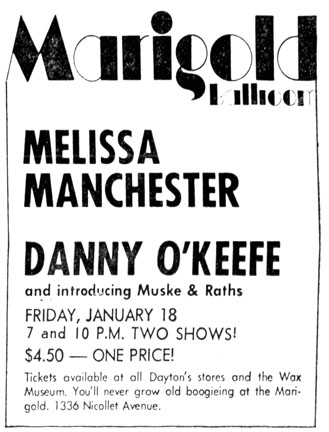
April 17, 1974: Foghat and Montrose. Show promoted by Owen Husney.
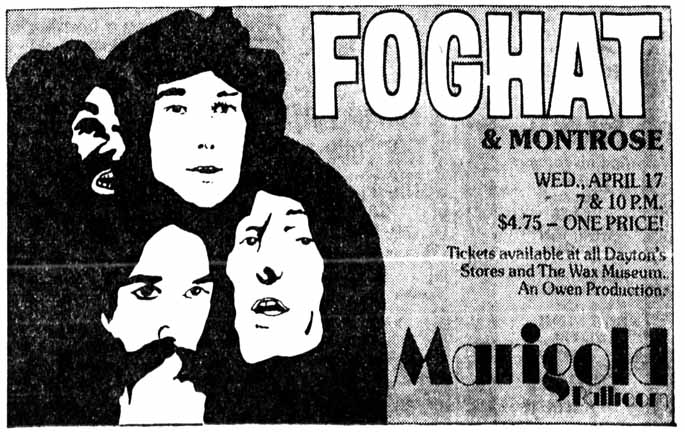
July 14, 1974: David Bromberg and Wendy Waldman (2 shows). Show promoted by Owen Husney.
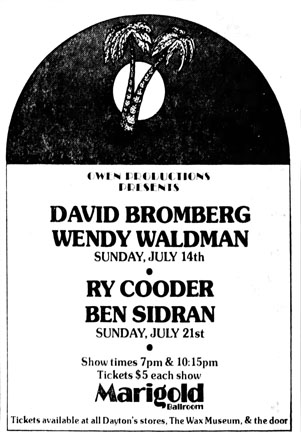
July 21, 1974: Ry Cooder and Ben Sidran (2 shows). Louis Kemp brought his old friend Bob Dylan in to see this show by pretending to be roadies. There were no incidents during the show, but word began to spread that he was there after the show and they had to get out quick. (Minneapolis Tribune, November 10, 1974)
Owen Husney remembers:
One of my crew told me that someone was at the door with Bob Dylan. Skeptical, I shouted at the dude, “You show me Bob Dylan and I’ll not only let you in but will buy you anything you want!” 5 secs later Dylan walks up behind the guy. Bob hung out after the show talking to Ry while the owner’s wife was sweeping up. Oblivious, she said, “You boys, show’s over! Get the hell out!” Bob left like a scolded child before I could get to her.
August 25, 1974: Dr. John. This show had to be cancelled due to a scheduling conflict.
October 13, 1974: Billy Joel, Brewer & Shipley. Show promoted by Owen Husney.
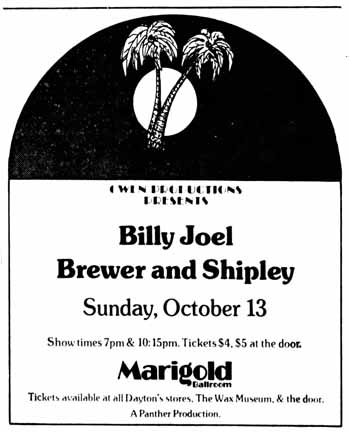
November 3, 1974: Heartsfield, Muske and Raths. Show promoted by Owen Husney. Originally scheduled for two shows, it turned out that the band was also booked at the U during the same week, hurting attendance at both venues. The U opened its show free to students, while Husney cut back to one show.
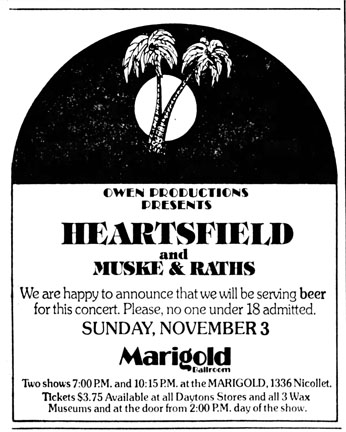
CLOSING OF THE MARIGOLD
The Marigold closed on May 24, 1975; the Tribune reported that the reason was “urban renewal.” Long-timers figured they’d have to go to the Medina to dance, but it was less civilized there – they don’t dance clockwise and people get bumped into. A Cupid Club of about 300 couples who met there and married got together for the last time.
The Larsons wasted no time holding an auction of the ballroom’s precious accoutrements. A wrecking permit was issued on October 7, 1975.
1300 Nicollet Mall was built in 1979 and is now the Hyatt Regency Hotel. The section sometimes known as 14 Grant Street is the parking lot.
THE ROOFTOP SIGN
It was in 1926 that the scaffolding for the huge sign was placed on the building. The top of it was 50 feet above the roof and it was 68 feet long.
The first sign on the scaffold read MARIGOLD BALLROOM in illuminated letters that were ten feet high.
Photos give us a hint of when the sign was changed. In pictures taken during the rehab process in 1950, we see that the iconic Grain Belt Beer sign was up. The latest date we can document is April 13, 1950.
That Grain Belt sign was moved to a small plot of land at 2 West Island Ave. on Nicollet Island in 1950, where it stands today. According to an MPR story from 2009 (quoted on Facebook), “The Eastman family, descendants of some of the first settlers of the island and the land’s first developers, owned this small parcel, which presented this prime location for advertising. According to a Minnesota Public Radio story in 2009, the original terms of the lease were $1,000 per month, plus 50 cents per barrel of beer.”
The building permit for 4 West Island Ave. is dated June 21, 1950, for a 40 x 60 x 100 ft. billboard, erected at a cost of $5,000.
Fun fact from Old Minneapolis: a similar Grain Belt sign was on N. Washington Avenue at 1st Avenue N. in the 1940s, the same general time that the Marigold sign went up.
By May 1953 the Marigold’s Grain Belt sign had been replaced with a City Club sign. A later photo shows a billboard for Calvert Reserve.
724 So. 4th Street. 1969: Bill Robertson, guitarist. This is the same address as Little Al’s, on the same June 1969 list.
Marty’s Bar, located at University and Grotto in St. Paul, was owned by Clayton Montpetit and Hank Belisle, a relative.
venue in 1957.
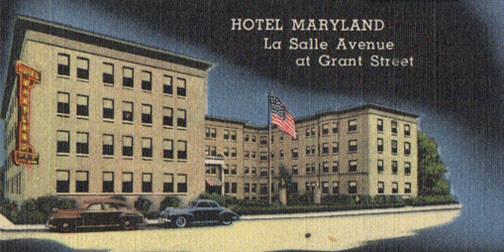
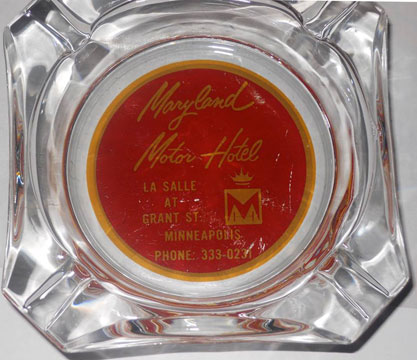
Ashtray from the collection of Mark Youngblood
This is just a catchall for the many lodge halls around that would sponsor dances and receptions. The Masonic Observer advertised one for rent in September 1919, but curiously gave no address. It may have been 8 North 6th Street. The Ark Lodge gave dancing parties every month over the winter of 1919 to 1920.
Hopkins. Matt Weldon bought the Beckman Confectionery in 1927 published an invitation to call and get acquainted in the Hennepin County Enterprise. His offerings included an “Amusement Room, Dance if you like. A delightful place to spend the evening.” No need to specify where this was, apparently.
Please see the Jail House.
Please see The Jail House
The Matthews Tavern, 1706 Fourth Ave. So., was the site of the “Town Talk Dance” that took place from 3am to 7am Christmas morning. The ad said it had the best dance floor, and that it (the venue? the dance?) was “Something New and Entirely Different.”
Mattie’s Barbecue had two locations: 1925 Fifth Ave. So., and 2934-36 Nicollet Ave.
MATTIE JOHNSON
According to an entry on Ancestry.com (thank you, Melinda Russell!) Mattie was born in Jeffersonville, Georgia. She and her two children moved to Minneapolis in 1950. After a brief stint at Minneapolis Honeywell, she became the first black salesperson at Donaldson’s Department Store. Her granddaughter Audra Russell (nee Hence) tells us that Mattie quit her job at Donaldson’s because, despite having the highest sales, she was denied a raise because she was Black.
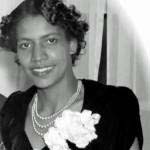
Mattie was also a well-known leader in community service. She was one of the first counselors at Twin Cities Opportunities Industrialization Center, and she was a founding board member of Sabathani Community Center.
MATTIE’S BARBEQUE
1955
Putting pieces of various sources together, it appears that Mattie began her barbeque business in her house at 1925 Fifth Ave. So. (at Franklin Ave.) in Minneapolis in 1955.
1958
In August 1958, Mattie opened her second location at 2936 Nicollet Ave. The rare ad below appeared in the Minneapolis Tribune. At this point it appears that both venues were just restaurants, although the Nicollet location had a bar- Mattie was the first black woman in Minneapolis to hold a liquor license. 2936 Nicollet was a tenement building that went back to 1892.
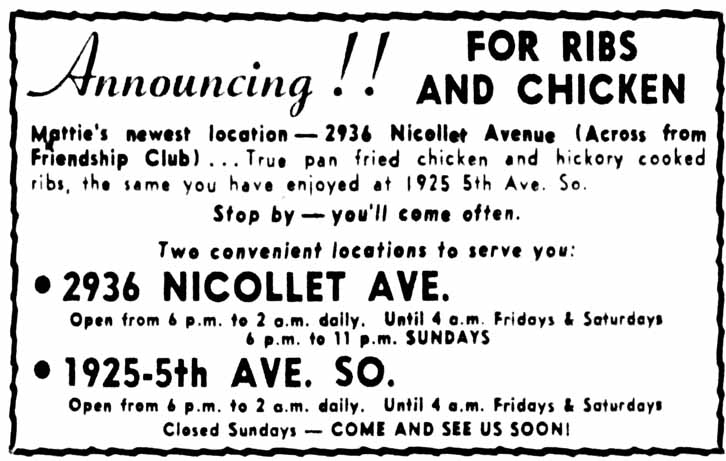
Minneapolis Tribune, August 28, 1958
CEDRIC APPROVES
Cedric Adams, entertainment columnist for the Minneapolis Star and Tribune, was a big fan of Mattie’s. He wrote the following in his column in the Star, dated September 26, 1958:
Success is always so gratifying. Months ago I discovered a little barbeque place located in the home of its owner, Mattie Hence, 1925 S. Fifth Av. Mattie started on pennies actually, but she had one premise – serve good food. Word came last week that Mattie has opened her No. 2 spot at 2936 Nicollet with improved facilities, larger quarters, but the same premise. In Mattie’s leanest days her benevolences were amazing. She fed the destitute, gave work or money to the indigent, had a helping hand for anyone in need. I hope she goes great guns in her new branch.
Cedric’s back on November 7, 1958, with this advice:
Paste these next few lines on your kitchen or amusement room cupboard door for handy reference: If you’re ever caught with a group of guests who linger late into the evening, call Mattie’s, 2936 Nicollet Av., TA 3-0902. She’ll have a pick-up order of fried shrimp, barbecued ribs, or fried chicken ready for you by the time you can get there. And this gal’s southern cooking is un-rivaled in town.
On December 2, 1958, buried in the classifieds under Category 74, Good Things To Eat, was an 8-line ad for Mattie’s that gave the 2936 Nicollet address and the menu of fried shrimp, pan fried chicken, and barbequed ribs. Apparently you could eat in or carry out.
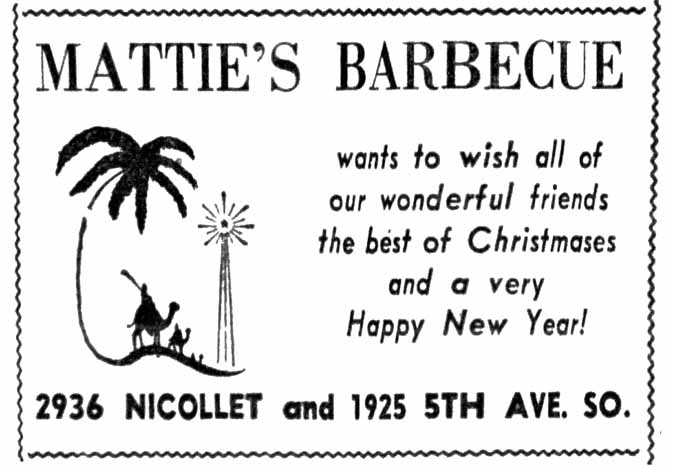
Minneapolis Tribune, December 25, 1958
1959
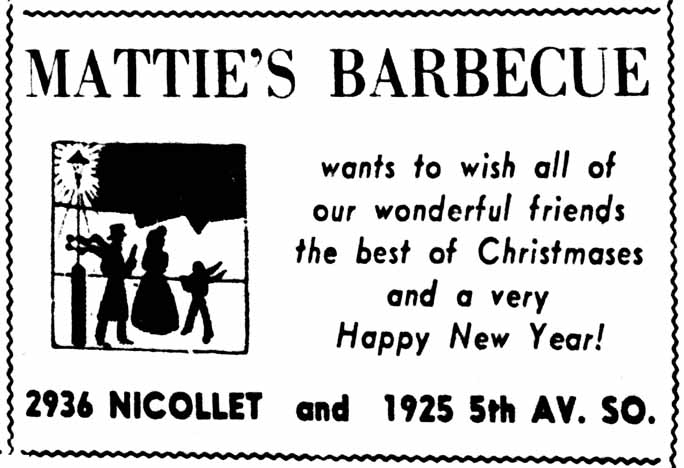
Minneapolis Star, December 25, 1959
1960
From March to June, 1960, there were small ads on the movie page for food from the Nicollet location.
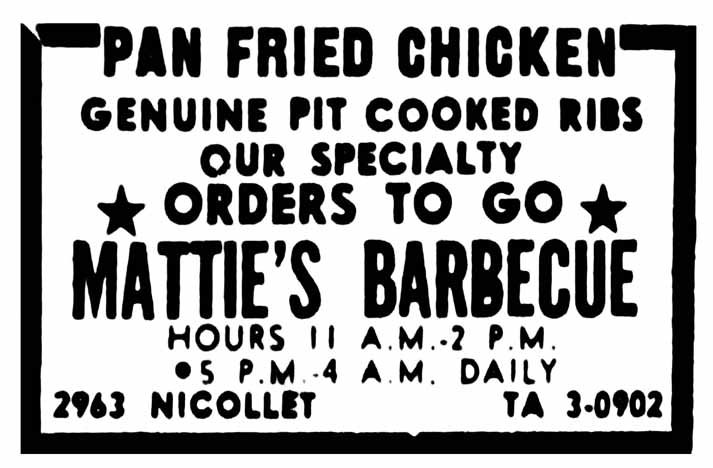
Minneapolis Tribune, March 19, 1960
The tenant next door in 2934 Nicollet moved out in July 1960 and Mattie took it over to expand her space. Cedric explains:
Tomorrow’s [September 17, 1960] a great night in the life of Mattie, the barbecue girl. Mattie decided to close her barbecue place on Fifth Av. off Franklin after many long years of successful operation and will concentrate all her activities in her refurbished spot at 2934-36 Nicollet. As Mattie says, “Just think, we’re gonna have paneled walls and ceilings and draperies and Venetian blinds at the windows. I’m really gonna go classy.” Good luck, Mattie, you’re a gem.
But…
Another Adams Goof: I thought after Mattie moved from her place at 1925 5th Av. to her new location on 29th and Nicollet that the old place was to be closed. It ain’t so. Gloria has taken it over as a chicken and steak place. Sorry Gloria.
The house on 5th Ave. So. went back to at least 1897 and was torn down in 1965.
MUSIC HITS MATTIE’S
Good Old Cedric gives us critical information here!
Mattie, the hostess-owner of a chicken and rib spot at 2934 Nicollet, has expanded once again. She began with the lower floor of a house on 19th and S. 5th Av., then moved to her present spot on Nicollet. She not only gobbled up the store space there next door to her, but now has put in music for Fridays, Saturdays and Sundays. Sandy and his Melody Boys play weekends. And this type of success couldn’t happen to a more deserving woman. Her chicken and rib take-out business is booming as well. (October 19, 1960)
It appears that the kind of music played at Mattie’s was eclectic to say the least. Sandy and his Melody Boys, the combo mentioned above, sound like a country band.
1961
A web page by Lyle Lofgren and Elizabeth Lofgren shows folk/country singers performing at Mattie’s in 1961. Performers include the Brandy Snifters, the Meeker County Boys, and Tony Glover. They certainly weren’t playing Calypso music!
And then Rhythm & Blues came to Nicollet Ave. Surely Howard Brown and his Rhythm Five weren’t from Mower County?
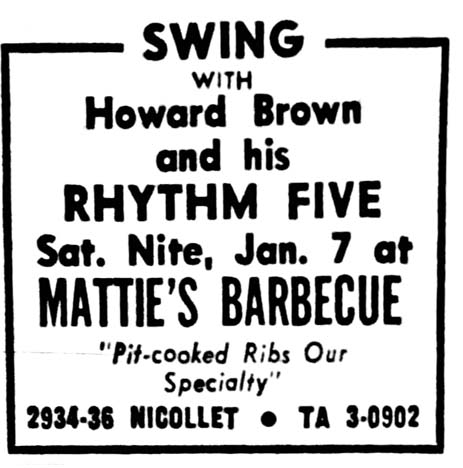
Minneapolis Star, January 1961
1962
The Little Sandy Review reported that there were folk sessions on Friday nights in January 1962.
Cyril Paul was the Calypso King of the ‘Cities. Although the ad below is from February 1962, Vic Burton was still talking about Paul’s act in his Night Beat column that July. The limbo was big at Mattie’s on Friday, Saturday, and Sunday nights. The record for this back-breaking dance was 16 inches – how low can you go? (Minneapolis Daily Herald, July 9, 1962)
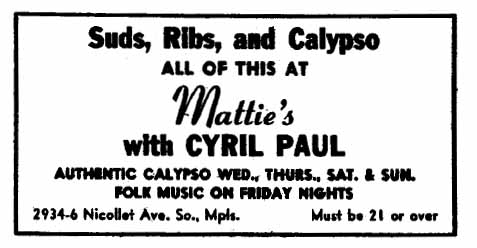
Minnesota Daily, February 1962. Ad courtesy Robb Henry
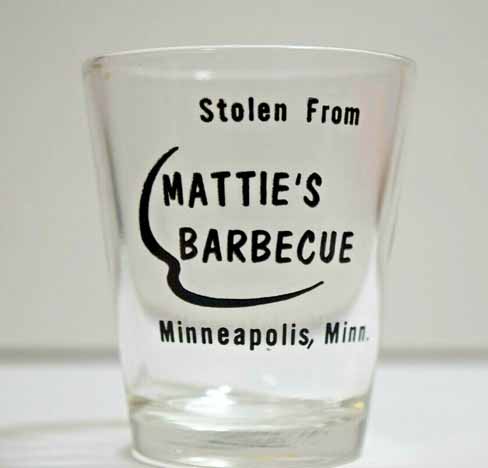
Jesse Fuller could do it all!
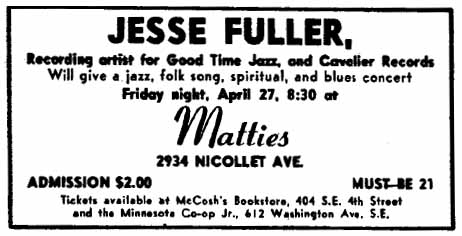
Minnesota Daily, April 27, 1962. Ad courtesy Robb Henry
“COURTROOM ROCKS TO BOOGIE BEAT”
This was the actual headline reporting a copyright case involving Mattie’s Barbeque. It seems that investigators from ASCAP, representing the publishers of a nifty tune called “Guitar Boogie,” claimed they heard a “music combo” playing the song on December 9, 1961, at Mattie’s, in violation of copyright laws. Mattie claimed she did not know what was being played. The defense attorney got permission from the judge to play a record to see whether the ASCAP stiffs could be sure what song they had heard. “The courtroom was jumping to the strains of popular music for a few minutes” that Monday. One investigator identified the record as “Guitar Boogie,” although it was really “Guitar Boogie Stomp.” (Shouldn’t that be “Guitar Boogie Shuffle?”) The judge said it was close enough and made Mattie pay a $250 fine. (Minneapolis Tribune, November 6, 1962)
Mojo Buford (billed as Blues Boy Buford in the ad below) played his “Tough Chicago Blues” at Mattie’s in 1962.
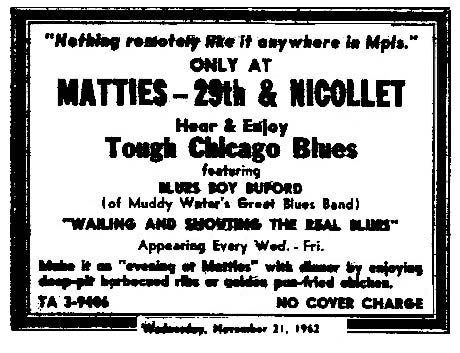
Minnesota Daily, November 21, 1962. Ad courtesy Robb Henry
1963
In May 1963 Mattie called Will Jones to tell him that she had started a “3.2 circuit Blue Monday session featuring Blue Boy Buford and his rhythm-and-blues harmonica” that started at 11 am and lasted to 3 or 4 pm. (Minneapolis Tribune, May 7, 1963)
Not quite sure what to make of this, but while Mojo Buford was working at Mattie’s, he also advertised for work in the classifieds in July 1963.
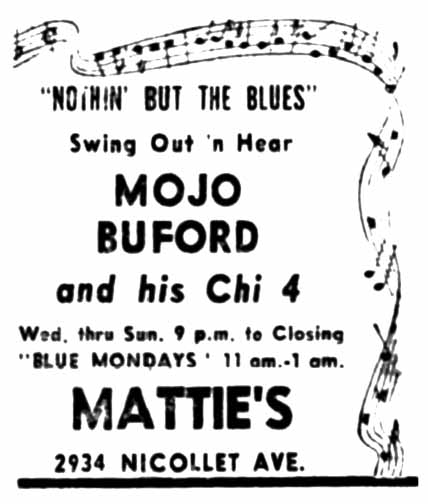
Minneapolis Tribune, October 16, 1963
1964
THE DANCE HALL DEBATE
Mattie had had a license for the performance of live music, but in 1964 she decided to apply for a tavern license as well so that people could dance.
In applications of this type, in addition to approvals from the building inspector, health department, police department, etc., applications must be approved by the Alderman in whose Ward the venue is in. There is no criteria for this – an Alderman can deny an application for any reason or for no reason, and the rest of the the City council goes along with it. This is called “Aldermanic Courtesy.”
In this case the Alderman for the Eighth Ward was Elsa Johnson, and she just did not want Mattie’s to have a tavern license. She brought up every reason she could think of, until it began to look like a racial discrimination issue – in 1964, it would have been one of the earliest touchpoints in Minneapolis.
One of Alderman Johnson’s objections was that Mattie’s was a wood framed, two story building, that went against the building code for a dance hall. But on the advice of the City attorney, the City council applied a broad interpretation to rule, saying that the code was meant for large dance halls, not small operations like Mattie’s, where the dancing was incidental to the use of the place as a restaurant.
On April 24, 1964, the Minneapolis City Council approved Mattie’s dance hall permit without a dissenting vote. Alderman Johnson was at a ground-breaking ceremony when the vote was taken. The vote broke a long precedent of Aldermanic Courtesy, although that practice did not go away. (Minneapolis Star, April 24, 1964)
The Alderman was not done yet. Even a later brawl that took place outside the bar between an off-duty policeman working as a bouncer and an unruly customer who got shot in the head was enough for Alderman Johnson to cry foul and demand the license be revoked. The cop wasn’t charged, the drunk lived, and Mattie kept her license.
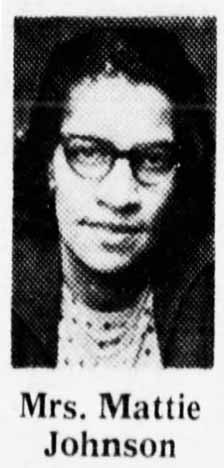
Mpls Tribune, March 26, 1964
JET MAGAZINE
The May 7, 1964, issue of Jet magazine did a feature story on this issue, taking the Council to task for not wanting dancing in an interracial venue such as Mattie’s. Fortunately, the magazine provided a photo of the inside of Mattie’s, showing the mix of the clientele. The name of the band was the Ambassadors.
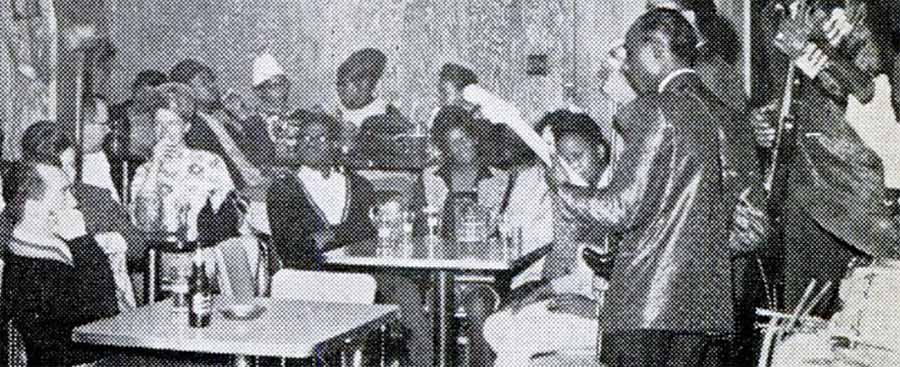
Jet magazine, May 7, 1964
Now that they could legally dance, the Calypso was back!
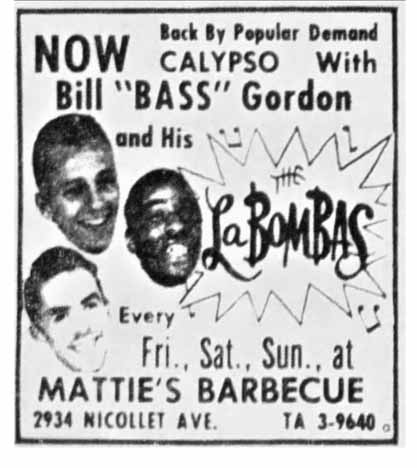
Minneapolis Tribune, July 4, 1964
MINNEAPOLIS LOSES AN ICON
Mattie’s on Nicollet went out of business and her beer license was transferred to La Pizzeria Restaurant, 33 W. Lake Street, on April 7, 1965. (Minneapolis Tribune, April 8, 1965) 2934-36 Nicollet Ave. was demolished in August 1974. In its place is that odious K-Mart that is blocking Nicollet Ave.
In the mid-’60s Mattie moved to Crosby, Minnesota, and established the area’ s first antique shop, Bits of Yesteryear Antiques. Crosby is now a major antique hub in the Crosby/Ironton area.
Mattie Hence Broden, 92, passed away Saturday, July 21, 2007. She had two children by husband Robbie Hence, one of which was Arnold Timothy Hence, and the other the aforementioned Audra Hence Russell. Her third husband was Phillip T. Broden.
The photo below was sent in by Robb Henry, who played guitar in Mojo Buford’s band (much later). One of his friends sent him the photo without much explanation. Audra Russell wrote in to clarify that this is actually Mattie’s third husband Philip T. Broden, Audra’s step-grandfather. That cash register is a work of art!
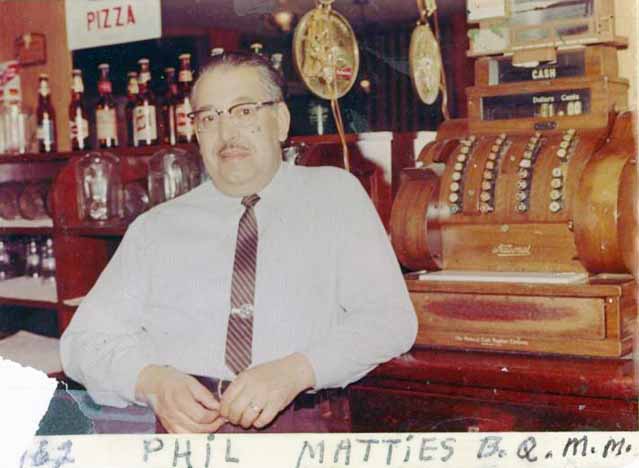
Photo courtesy Robb Henry
Thank you to Audra Russell for her corrections and clarifications! Audra also sent a photo of herself in 1992, with her grandmothers. Mattie is on the left.
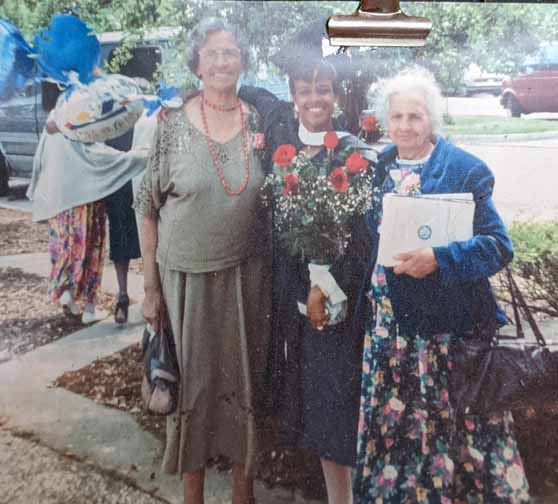
Photo courtesy Audra Russell
St. Paul – jazz venue
1428 Fourth Street NE, Minneapolis. I normally don’t do polka, but this place is legendary!
It appears that this building was built as a saloon and flat in 1900, according to the Minneapolis Permit Cards. During Prohibition it was a cafe/restaurant. J.C. Johnson ran a soft drink bar in January 1922. William W. Johnson was listed at this address in November 1924.
JOHNSON’S PLACE
When Prohibition ended, the establishment became (or continued to be called) Johnson’s Place. Although it was owned by William W. Johnson, it was William’s brother Eugene J. Johnson who received one of 23 on-sale liquor licenses on January 26, 1934. A New Year’s Greeting in 1938/1939 was from “Bill and Gene.”
The photo below is of William’s son, Johnny, tending bar at Johnson’s Place in about 1935. John died in 1937. At the bar with the hat on is William’s other son Victor, and Victor’s brother-in-law, Lawrence Mikolajczyk, next to him.
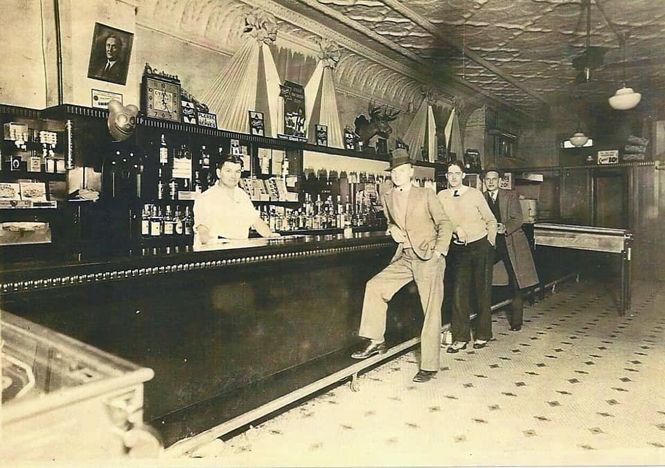
Photo courtesy Mary Jean Johnson DelPrincipe
In late 1945, the liquor license was transferred from Eugene J. Johnson to Eugene J. Johnson and William Johnson.
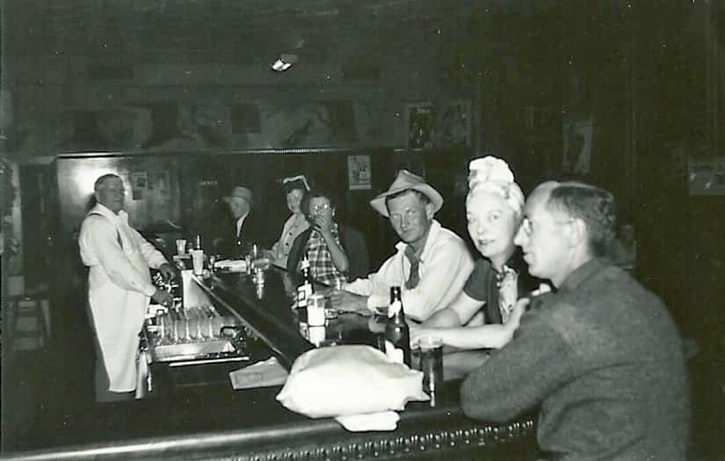
William Johnson behind the bar. Photo courtesy Mary Jean Johnson DelPrincipe
The notepad below indicates that William’s son Victor was a partner in the business after 1938/1939.
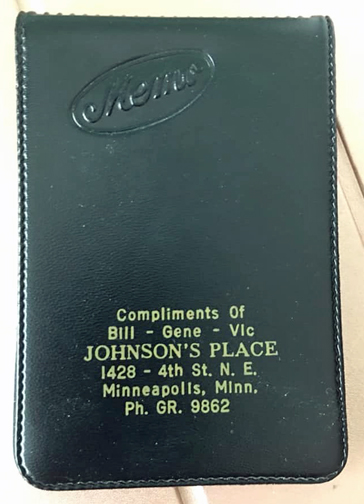
Photo courtesy Mary Jean Johnson DelPrincipe
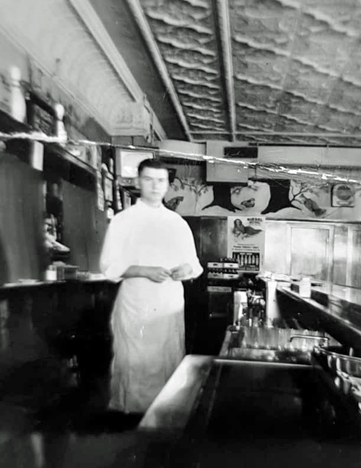
Victor Johnson. Photo courtesy Mary Jean Johnson DelPrincipe
As far as I know, there was no live entertainment at Johnson’s Place, just a jukebox that played 78s, according to Victor’s daughter, Mary Jean Johnson DelPrincipe.
MAYSLACK’S
By August 1955, the Johnsons had sold the place to wrestler Stan Mayslack. Mayslack was a colorful character around town, and served only one item on his menu – giant roast beef and garlic sandwiches.
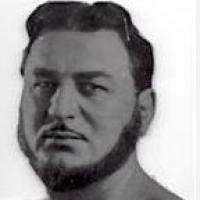
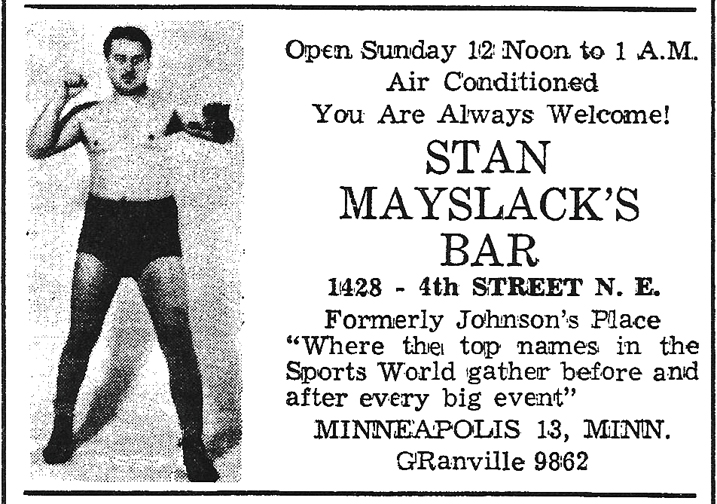
This 1955 ad comes from a program for the 32nd Annual Polish National Alliance Convention, held that year in Minneapolis. Courtesy Jeff Lonto.
From Mayslack’s website:
The history of Mayslack’s begins with Nordeast native Stashu Maslajek. Born to Polish immigrants in NE Minneapolis in 1911, Stashu – or “Stan” – developed a love of pro wrestling and moved to Chicago to make his mark. “Handsome Stan,” as he was known, was a crowd favorite in the Upper Midwest pro wrestling circles in the ‘30’s and ‘40’s. Along the way he Americanized the spelling of his Polish surname to Mayslack so it was easily pronounceable for wrestling fans. When his ring career ended in the 1940s, Stan Mayslack continued for a time as a wrestling and boxing promoter.
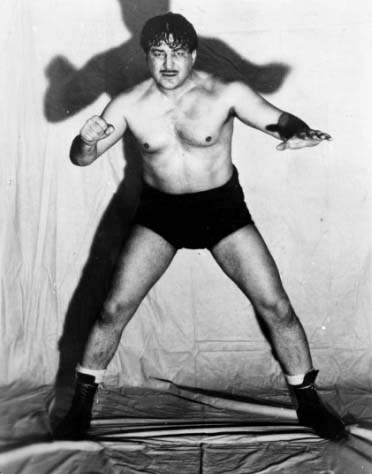
Minnesota tugged at his heartstrings, however, and in 1955 Stan and his wife Ann (who everyone called “Butch”) purchased an old tavern called Johnson’s in his beloved Nordeast neighborhood. Renaming it “Mayslack’s,” Stan began pouring drinks, hiring polka bands and serving his now-famous garlic roast-beef sandwiches.
From the beginning, Mayslack’s was a partnership between Stan and his wife. With Stan making his sandwiches, Butch ran the till using a cigar box as their cash register. Stan and Butch lived in an apartment above the bar. Many times while upstairs, Stan would call down to the bar wanting to know who was there, followed by a free round of drinks for the people he selected. Mayslack’s was famous for organizing bus trips to Gopher and Vikings games and Nordeasters liked to congregate at the bar on Monday evenings to play a card game called Smear.
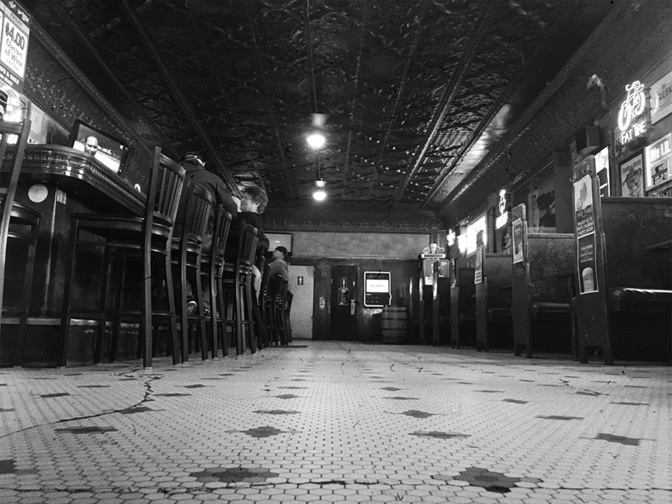
A neighborhood corner bar from the beginning, Mayslack’s still retains its original “divey” feel thanks to its largely-unaltered interior. As one reviewer noted, “the floor tiles are cracked, the bar is dimly lit, and the booths are creaky and private. It is simply a dive bar. And I immediately loved it.”
The Music
The three main ethnic groups that settled in the early NE Minneapolis neighborhood were Polish, Russian Orthodox and Czech, and it is their polka music that made what is now known as the Nordeast neighborhood unique.
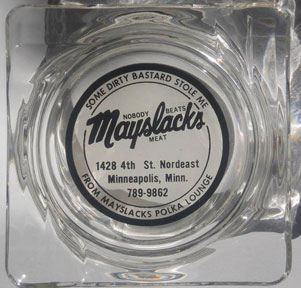
From the collection of Mark Youngblood
It is said that Stan Mayslack celebrated everything. He featured parties throughout the year for New Year’s Eve, Orthodox New Year, Valentine’s Day, Chinese New Year and more. These holiday parties were always a good excuse to have local Polish polka bands entertain, playing to overflowing crowds. In fact, when it first opened, Mayslack’s bar was listed in the phone book under “Mayslack’s Polka Lounge.” Polka bands from far and wide played regularly at Mayslack’s, and the venue’s rich polka history is widely noted.
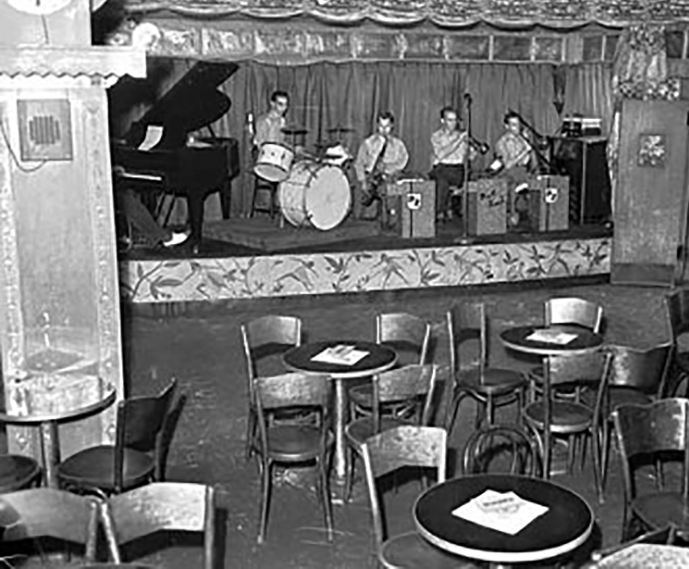
While you can still find polka in the jukebox, Mayslack’s has since its expanded its repertoire to include all genres of live local music. What has not changed, however, is that Fridays and Saturdays you can still find a packed house of live music lovers!
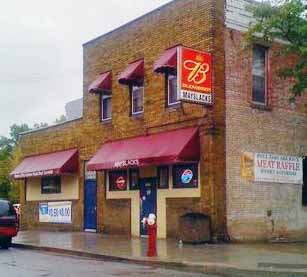
Photo from Mayslack’s website.
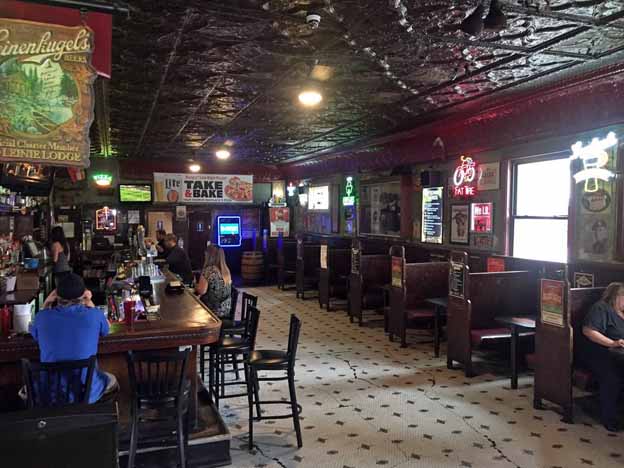
Photo from Mayslack’s website.
The Mazourka/Mazurka Hall was the oldest music venue found in the database of the Minnesota Historical Society, shown in the photo below from 1890.
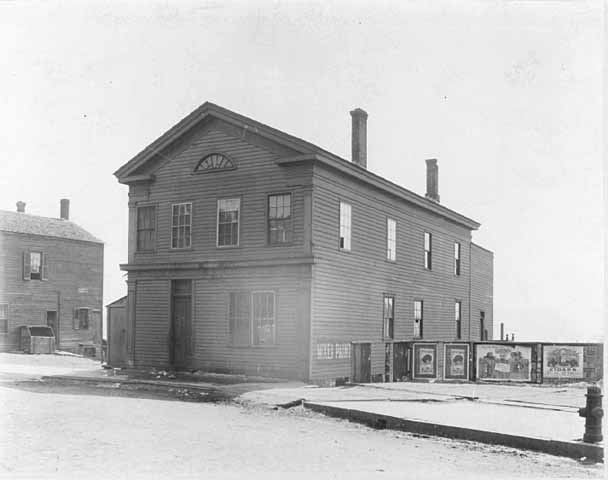
As it turns out, Russ Hanson has done quite a bit of research on the hall, and provided this summary:
Pretty much forgotten now, the Mazourka was a very important landmark in the earliest days, as it was the first dedicated outlet for fun, hosting nearly all of the early cultural performances and events when St. Paul was just beginning. How ironic and fitting that our later large auditoriums and Civic Centers have all been built within a stone’s throw of this place.
Built in 1850, Mazourka Hall was the scene of social balls, political meetings, dramatic, comedic and musical events and even held district court here in 1851. It was located on the SE corner of 3rd (Kellogg) and Exchange St. (across the street from present day Excel Center’s southeast entrance doors).
I’ve done a time merge here also to try and help show the site at its exact location. The upstairs was the ballroom or hall; the downstairs housed Elfelts Store.
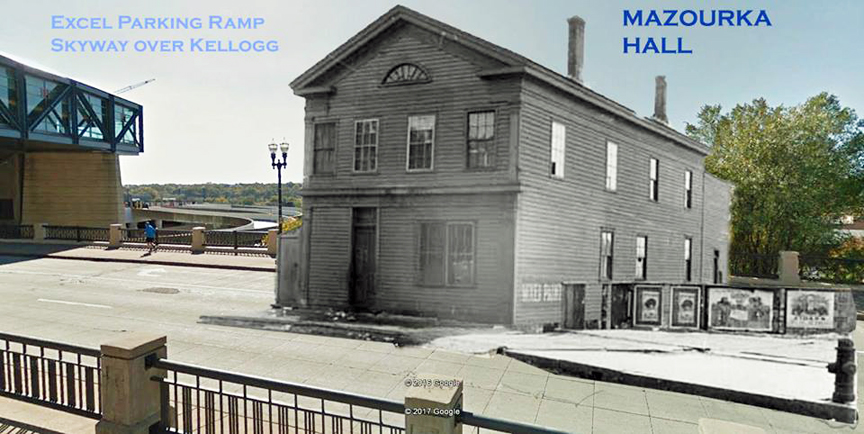
On October 14, 1850, the editor of the Minnesota Chronicle and Register newspaper wrote “Elfelts (Abrams Elfelt) new store is 70’ deep opposite the American house and is almost complete. When complete there will be balls given on the second floor and the name the Chronicle would like to suggest is Mazurka Hall.” Misspelling aside on the suggestion, Elfelt did name the hall “Mazourka Hall” and it became the place to be in the 1850 social season , a time when there were very few places for folks in St. Paul to gather. Soon there would be many halls and hotels built for such occasions but in the early 1850s the Mazourka was the place to be and be seen.
Below is another photo from Russ, showing the location of the Hall in old St. Paul in 1908.
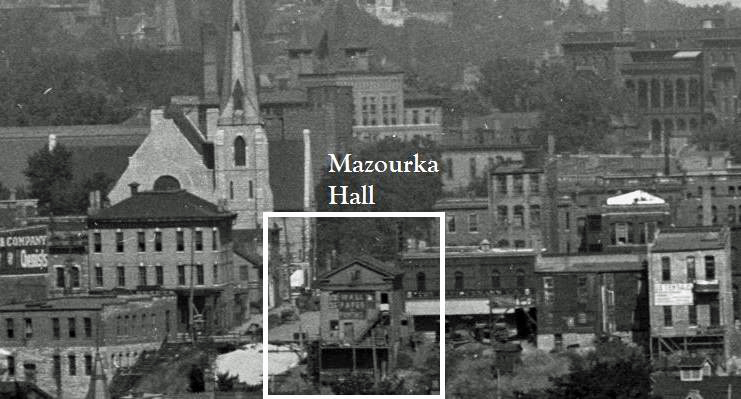
Jim Sazevich describes the building’s history post-music:
The hall was owned and operated by a long list of Jewish businessmen and women, as a grocery store, confectionery, auto battery and tire sales, boarding house, etc, for decades after it ceased serving as a public meeting hall and theater. I believe it was lastly used for a carpenter / cabinet making shop by Carl J. Flater (1885-1959) in 1925, before it was razed that year or the next.
Save
Save
Save
Save
Save
McCarthy’s Cafe was one of the fanciest nightclubs in town, back in the days when people dressed up to go drinking and dancing and eating and smoking. The address was 5600 Wayzata Blvd., on the north side of the road, which normally would have been in Golden Valley, except that the road and the city boundaries diverged in that area.
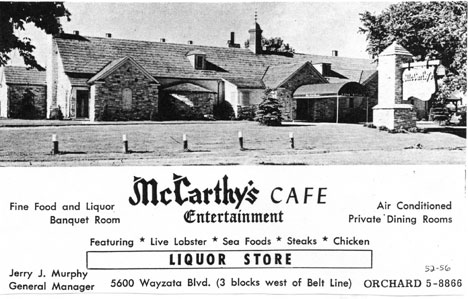
Phone book ad, 1952 to 1956
It had cushy booths and a sophisticated atmosphere, as can be seen in these photos from 1956, courtesy Minnesota Historical Society.
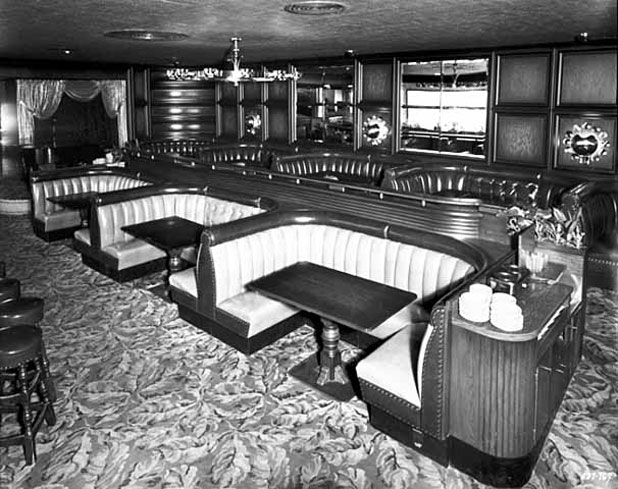
KEITH McCARTHY
Keith Donald McCarthy was born on December 29, 1914, in his home at 5809 Goodrich in St. Louis Park. He graduated from St. Louis Park High School in 1933 and attended the University of Minnesota. After working for Northwestern Mutual Insurance Company in Minneapolis, he became a pilot for Northwest Airlines. During World War II he flew ice research missions for Honeywell. Once he became part owner of a restaurant and liquor store in 1942, however, the airline found it unseemly for one of its pilots to be in the bar business and gave him a choice. McCarthy was making more money at the restaurant so he gave up flying. He left McCarthy’s Cafe in 1947 and relocated to Salt Lake City where he opened the Golden Flame Restaurant. He moved to Woodside, California, (Bay area) in the early 1950s. There he founded McCarthy Company Insurance and “made millions” until he retired in 1985. Keith’s first wife was Virginia Howard (December 20, 1916 – March 14, 1981). Daughter Patricia J. McCarthy was born in about 1950 and she married James B. Brady in 1976. After Virginia’s death he married Jean Smith. His obituary said that “he loved flying, music and sailing. He owned a boat docked at Pier 39 in San Francisco and sailed the Bay as much as possible.” He also sailed the Adriatic and Aegean seas. Keith McCarthy died on January 7, 2002, at age 87.
Meredith McCarthy told the story that his brother Keith applied for a liquor license for a restaurant and bar at Highway 100 and Excelsior, where the Lilac Lanes Cafe and later the Kings Inn went. Ceding to pressure from local ministers, the City Council said no to the location, but gave him a liquor license, even though he had no experience with a restaurant. This was in 1942, and there wouldn’t be another license available until the next census (1950). Keith was 25-26 years old at the time. It’s said that Mayor William Martin was on gangster Tommy Banks’ payroll (around $50 a month) and he introduced Tommy to Keith. Tommy had wanted a restaurant on Wayzata Blvd. but couldn’t get one as a convicted felon.
They purchased 9+ acres on either side of Wayzata Blvd. and sold the southern part to the Minneapolis Baseball people. They started to build in 1942. Because of the war there were restrictions, but if they could get a certain amount into the ground by a certain date, they could keep going. This is why there is no basement. The restaurant opened in 1942.
The building was a long rambler type, covered with stucco. The windows were crisscrossed. The northeast corner was the liquor store, southeast was the entrance, east was parking, and west was the restaurant. There were booths down the center, and other, private booths where you couldn’t be seen. Over the bar was a big picture window with a rock garden and waterfall. The place was always impeccably landscaped.
An ad from 1944 is chock full of interesting enticements:
“Good Food Our Specialty”
The Suburbanite’s Rendezvous!
McCarthy’s Cafe solves the problem of “Where to Go.” Its restful and beautiful atmosphere is yours to enjoy and an evening dinner is a delightful cure for that “let down feeling.”
TWIN CITIES DREAM SPOT.
Frank Rerat, Chef; Ted Culbertson, Manager.
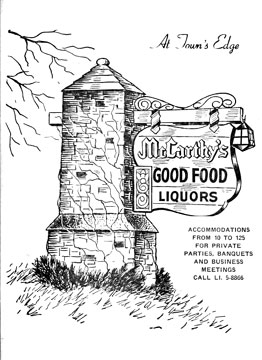
Ted Culbertson was first the liquor store manager, then restaurant manager. He was brought in from a liquor store downtown. He left in 1946 to establish Culbertson’s. Jerry Murphy, a former Marine from Duluth, was manager for a very long time.
In March 1946, excavation began for an addition to the west side that quadrupled the size of the restaurant.

Ad in the Minneapolis Tribune, February 2, 1947
The new stone exterior gave the building an Old English appearance. Landscaping was done by Morten Arneson. The design won an award from “architects of the country who recently voted it the country’s outstanding suburban restaurant, architectuarily” according to the July 11, 1947, edition of the Dispatch.
Meredith McCarthy remembered some of the characters who frequented the establishment:
-
An actor from Fibber McGee and Molly, who, although he was in radio, got recognized a lot.
-
Auzie Dial, a black pianist who was really a jazz musician, but played pop tunes for the crowd.
-
Mel Hanson, who never paid for anything less than a $20 bill, even for a 50 cent drink. A Jim Klobuchar article reported that he retired (from owning apartments) broke but happy.
-
Lorraine Johnson was a popular waitress.
-
The mayor’s chauffeur usually got drunk.
Keith McCarthy left McCarthy’s in 1947 but left his name as a legacy.
The restaurant’s dinnerware was made by Walker China, according to the Restaurant Ware Collectors Network. Here are photos:
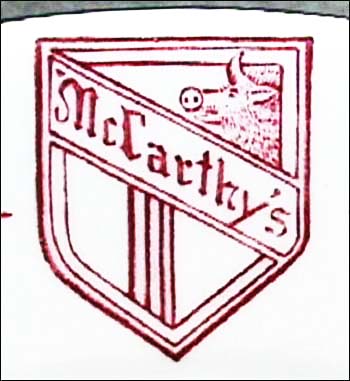
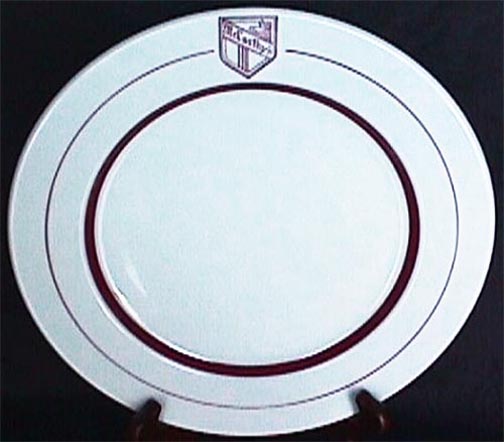
On October 27, 1950, there was a slight change in stockholders:
- Jeremiah Murphy was President and Director
- Reta Banks (Tommy’s wife) was Secretary, Treasurer, and Director
- Harry H. Clark was a Director
Shareholders were:
- Reta Banks: 110 shares
- Harry Clark: 110 shares
- James J. Keefe: 82 1/2 shares
- Harry Shepard (Tommy Banks’ longtime partner): 27 1/2 shares
In 1952, Highway 12 was widened and McCarthy’s placed on a service road; in 1953 the road was scheduled to be redesigned, and a signal was installed at the intersection.
Officers in 1956, each holding 110 shares, were Jeremiah Murphy, Rita Banks, and H.H. Clark.
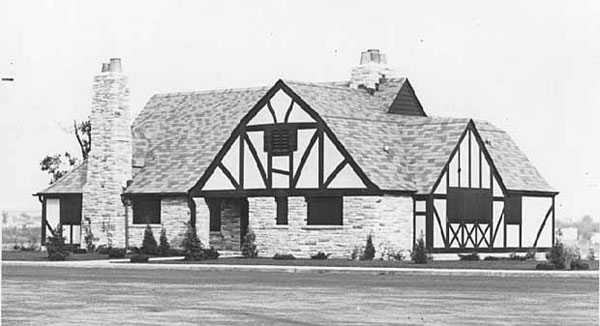
The photo above is in the Minnesota Historical Society database as McCarthy’s in 1956, but it it probably (more than probably) not. Ben Haney wrote to say that it looks suspiciously like the clubhouse at the Hiawatha Golf Course in South Minneapolis!
Tommy Banks didn’t have a lot of time to enjoy his place from 1955-1957, since he was residing in Leavenworth on a tax fraud charge. The correspondence sent from that Institution to McCarthy indicated that something was up and that Tommy still called the shots.
In 1955 McCarthy’s was accused of racial discrimination when management refused to upgrade the position of Carl L. Carter from bus boy to waiter because he was black. Carter was subsequently fired because he had filed a complaint under the Minnesota Fair Employment Practices Act. FEPC staff underwent an intensive investigation and made “patient and prolonged efforts … to eliminate the unfair practice by conference, conciliation and persuasion,” but McCarthy’s still failed to comply. A public hearing was held by the FEPC Commission, the first such action taken under the provisions of the law, which was enacted in 1951. Manager Jerry Murphy testified that he was not personally prejudiced against Negroes, but that he “doesn’t set the policy at McCarthy’s, that he is following orders and that he has certain orders he has to take.” (Minneapolis Spokesman, September 6, 1957)
A 1960 restaurant review describes a picture window that overlooks a brilliantly-lighted rock garden and waterfall. That year the restaurant was redecorated in the Italian Renaissance style. In the central dining room, Bill Bockman played the organ (“light and sprightly”) in a “draperied alcove.”
A 1962 ad for McCarthy’s – “At Town’s Edge” – ad promised “Fast, Efficient Service to Club, Office, or Home.” John Ralles was the Liquor Store Manager. In 1966 Ralles was replaced by Glenn A. McArthur, who has written a memoir about his time at the restaurant and his impressions of his boss Tommy Banks – a MUST READ!
CHANGE IN OWNERSHIP
In 1968 a limited partnership purchased McCarthy’s for $951,000 cash. Partners were:
- Stanford Clinton, Jr., of Golden Valley
- Stanford Clinton, Sr., Miami
- Bruce Clinton, a banker in Miami
- Irv Kupcinet, columnist for the Chicago Sun Times
- Arthur Morse, Chicago attorney
- Frank McGarr, Chicago attorney
- Thomas P. Fox, “a Californian”
The Clinton family had owned the building that housed Freddie’s Cafe in downtown Minneapolis. That building burned down in 1966. The family also owned a motel in California, two lodges in Aspen, and apartment houses in Miami. Clinton planned to build a motel of 250 to 300 rooms on the property “as quickly as possible,” reported the Minneapolis Tribune on April 17, 1968.
The Sun reported that “The licenses were granted only after a series of long distance phone calls placed during the [council] meeting satisfied councilmen as to the relationship of the elder Clinton to a Teamster’s Union welfare fund. Clinton, an attorney, had represented such a fund, it was learned, but has not done so for more than a year. Satisfied with that response, the council granted the [Sunday sales, on-sale and off-sale liquor licenses].”
“McCARTHY’S CAFE WAS A LEMON”
On January 7, 1970, the Minneapolis Star reported that new owner Stanford Clinton, Jr. sued the former owners of McCarthy’s, including Tommy Banks, charging that they sold him the cafe with fraud and breach of contract. “Clinton charged he found kitchen equipment, plumbing and electrical installations in disrepair, the carpet shoddy and the roof leaky.” He estimated that the cost of repairs would be $250,000. He also charged that the sellers misrepresented the restaurant’s worth by showing him financial statements for the previous year rather than the year of the sale. He sought return of his $951,000 purchase price and more than $500,000 in damages.
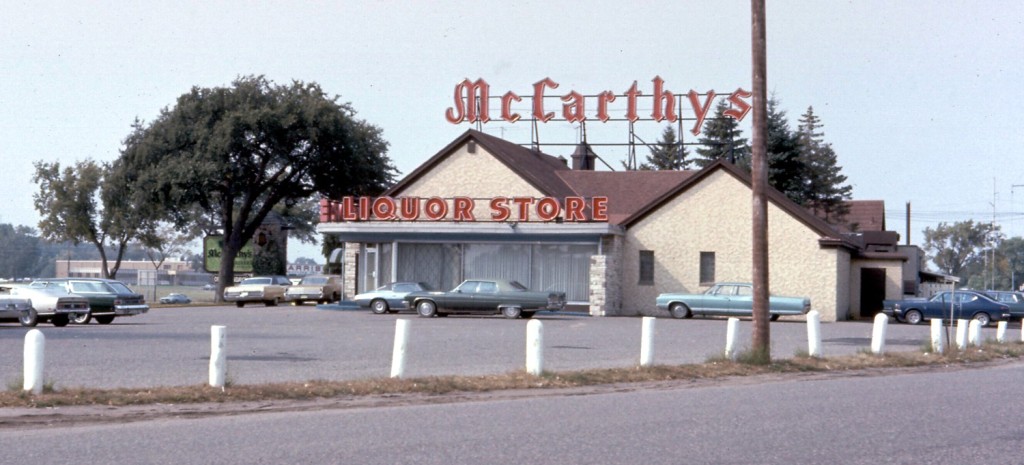
McCarthy’s in the early 1970s
The restaurant became Eddie Webster’s-West sometime after 1972.
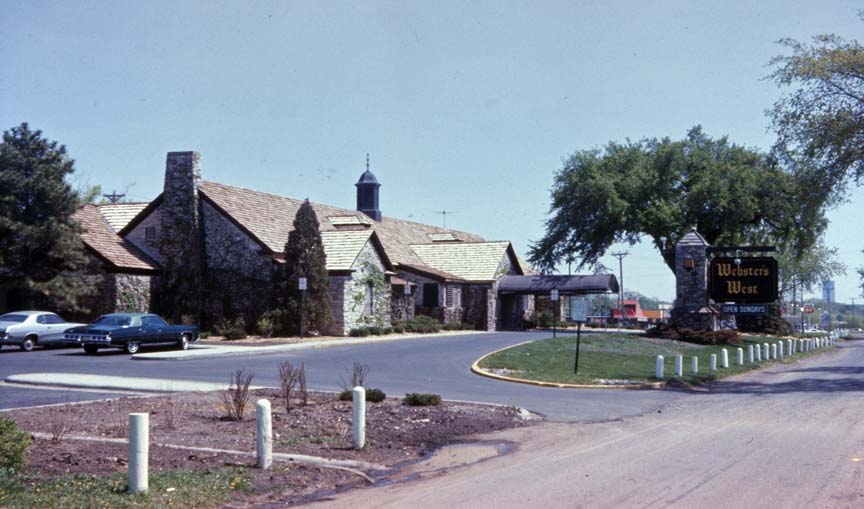
In January 1980 the restaurant reopened as Sweet Caroline’s. An article in the Park High Echo noted its stained glass windows, fireplace, Tater Bar, and many small rooms. There were two bars, one with disco and one with a rock band. The dining area accommodated 192 people, with another 75 seats in the Tater Bar.
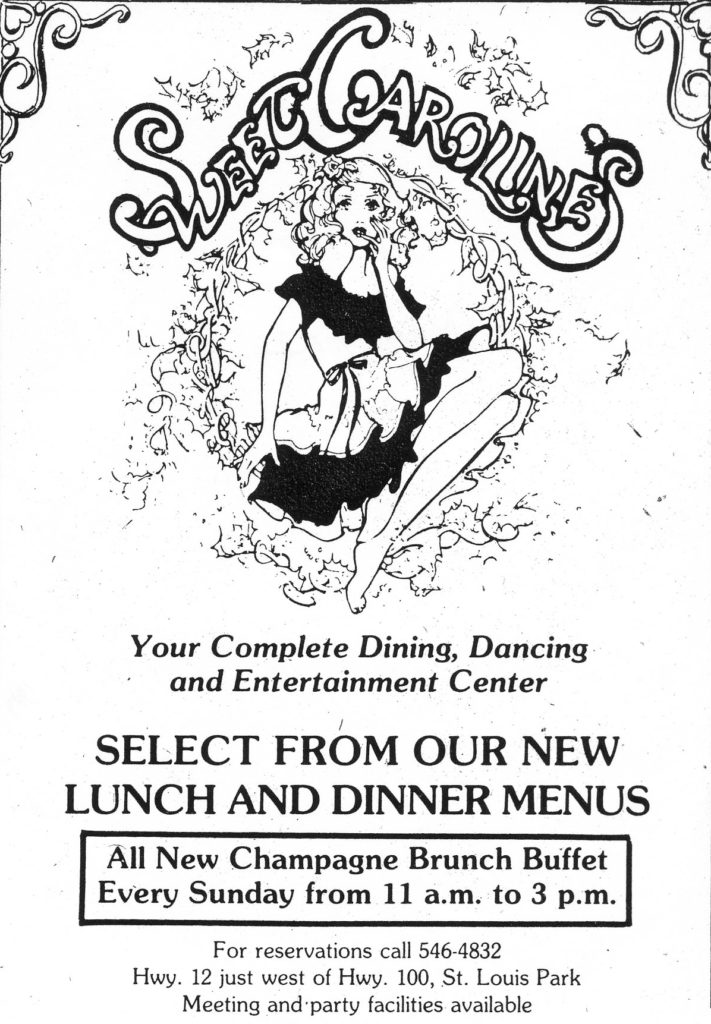
1980
The board of directors of Sweet Caroline’s included:
- Bruce Burton, Minneapolis – President
- A. Lachlan Reed, Orono
- Mark Stenglein, NE Minneapolis
- William C. Brown, Los Angeles
- Eddie Webster, Minnetonka
The director of operations was Shel Berlatsky.
The building was razed in about 1991 to build I-394 and thousands of cars drive over the spot every day.
Please see Nando’s Hideaway.
McGuire’s Restaurant and Lounge was located at 1201 W. County Road E in Arden Hills, three miles north of Highway 36 on US 10 between Lexington and Snelling.
McGuire’s seems to have opened in or before 1961.
Normally a more sophisticated place, McGuire’s bowed to the folksinging craze in 1963.
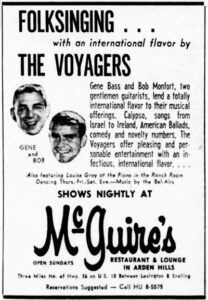
As early as 1966 it featured the Lamplighters Singing Sextet, formerly the St. Paul House Sextet.
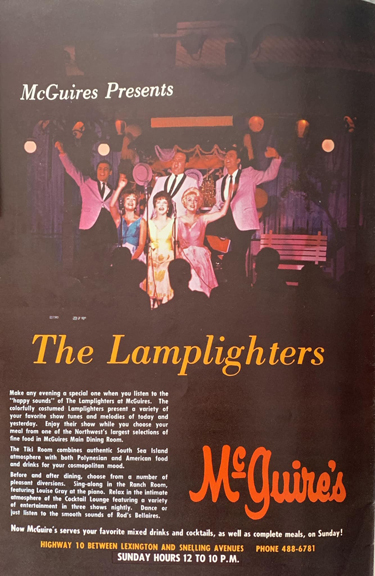
Image courtesy Jon Murphy

Minneapolis Star, October 13, 1966
In 1970 it was called the McGuire’s Supper Club: Fine dining, dancing and entertainment in one of the largest dining rooms in the upper Midwest; dinner shows, lounge entertainment.
The names of the rooms had changed from 1966. The Ranch Room was now just the Piano Bar. The Tiki Room was still there, but there was now a Shamrock Room for dancing, and a German buffet in the Gasthof Room.
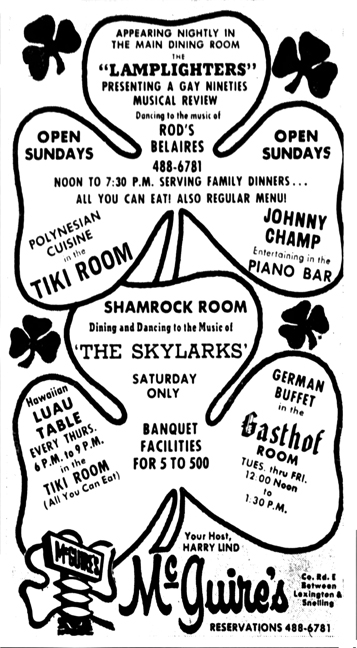
Minneapolis Star, April 23, 1970
In 1973 a notable act was the Kirby Stone Company, featuring the leader of the Kirby Stone Four.
An August 1974 ad was for McGuire’s Continental Room at the new Ramada Inn, same location, featuring Ginna & Joel. Also Carole Martin in the Chimney Sweep Lounge.
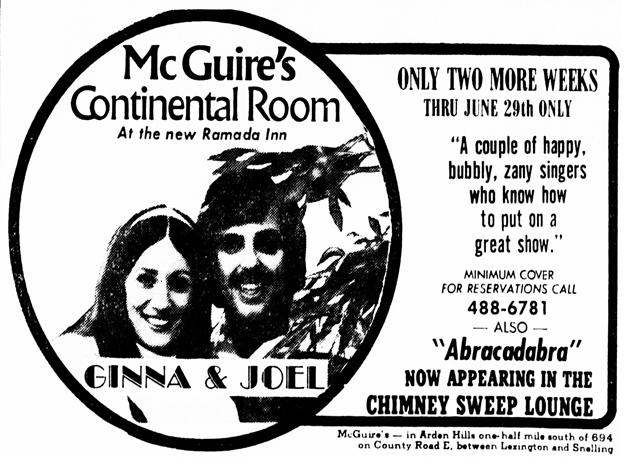
Minneapolis Tribune, June 14, 1974
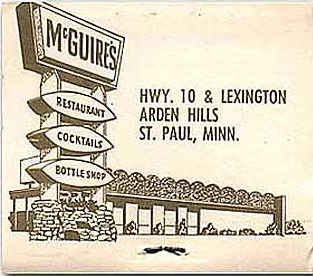

The last match found in the Minneapolis papers was on July 1, 1982.
The Meadow Inn was “Straight Out Cedar Avenue South to Minnesota River Bottoms.” A 1956 article gave the address as 3000 E. Black Dog Road.
An ad dated July 1943 promised picnic grounds and dancing every Friday, Saturday and Sunday evenings.
There was a Meadow Inn Park in the same area in 1945.
Unfortunately, reports of robberies are the best sources of information about the owners of establishments. In October 1956, a “swarthy, loud-mouthed gunman” held up owners Mr. and Mrs. Frank Schoeder.
In June 1958, two youths killed owner Donald Haeg during the commission of a robbery.
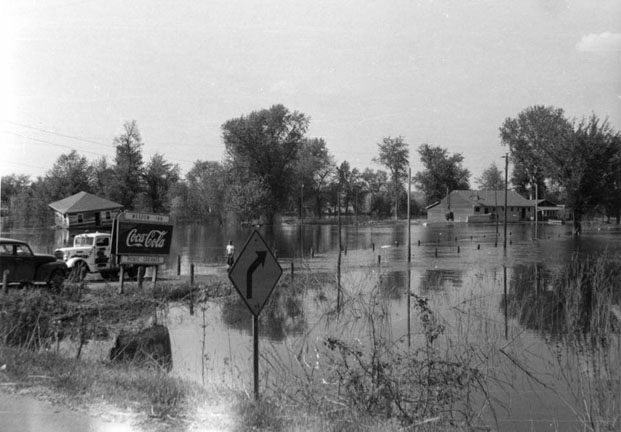
Photo of flooding from May 1952
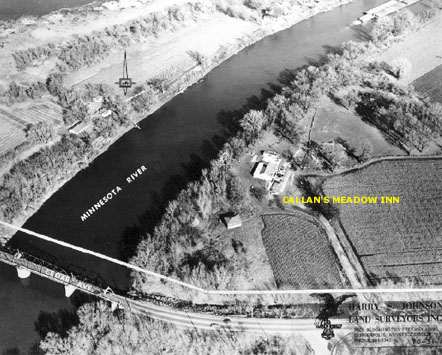
Aerial shot from the Dakota County Historical Society
The Meadowbrook Roadhouse was in New Brighton.
The Meadowmoor Lounge and Supper Club was usually described as being located one mile north of Soderville on Highway 65. Its address was 18803 Highway 65 NE, East Bethel in Anoka County.
Ads for staff began in July 1966.
In May 1967 the manager was Arnold Neitzel.
Gary Brunotte wrote to say that his band the Three Shadows opened the club in 1967.
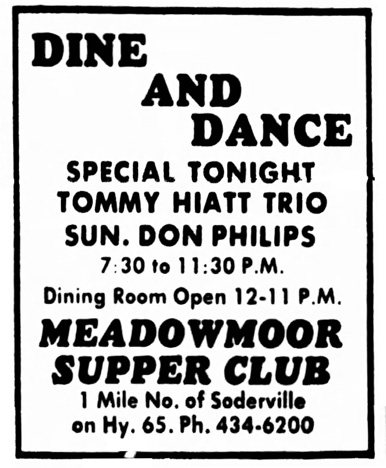
Minneapolis Star, September 21, 1968
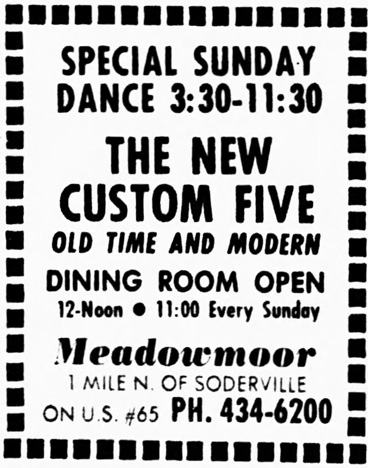
Minneapolis Star, October 19, 1968
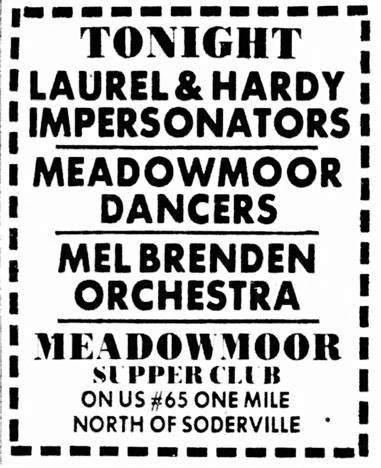
Minneapolis Star, April 25, 1969
The lineup in June 1969 was:
- Wayne Reinhart & the New Custom Five
- Don Phillips Band
- Gene Fournier Band
- Tony Jambor Orchestra
- Polka Debonaires
- Dave Lory, country western impersonator
In February 1970, the Meadowmoor was the site of snowmobile auctions, with WCCO’s Chuck Lilligren as auctioneer.
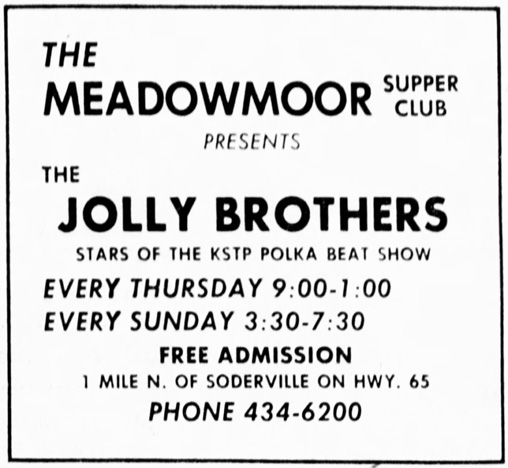
Minneapolis Star, March 19, 1970
DRAM SHOP LAWSUIT
It appears that the following lawsuit may have spelled the end of the Meadowmoor. When someone who has been drinking at a bar becomes too intoxicated to drive, and then harms another while driving drunk, the bar becomes responsible. The Meadowmoor was insured by Lloyd’s of London. This case was about liability in such an accident. The language below is quoted from Mattson v. Underwriters at Lloyd’s of London 385 N.W.2d 854 (1986)
On April 1, 1973, Glenn D. Mattson was seriously injured when the car he was driving was struck by Glen V. Johnson’s car. Johnson was driving while intoxicated. He had been drinking for several hours at the Meadowmoor Supper Club.
Meadowmoor was owned and operated by the Car-Del Corporation at the time of the accident. Lloyds carried the dram shop insurance for Car-Del.
Mattson brought suit against Car-Del and Johnson on January 1, 1976. He sought damages on behalf of himself, his wife, and their minor children. In the lawsuit Mattson claimed that Johnson was negligent. Mattson also claimed that the employees at the Meadowmoor Supper Club had served liquor to Johnson while he was obviously intoxicated in violation of Minnesota’s Dram Shop laws.
Car-Del voluntarily dissolved by filing a certificate of voluntary dissolution on July 29, 1976. Car-Del had previously filed a notice of claim against Lloyds.
[In March 1977 the club was advertised for sale.]
Johnson’s insurer paid Mattson his $10,000 policy limit soon after the lawsuit was commenced.
On several occasions Mattsons attempted to settle their claim against Car-Del for what Lloyds claimed were the policy limits of $100,000. Lloyds refused to accept and offered $40,000 instead. No settlement was reached.
Lloyds defended Car-Del at trial. A jury found that Johnson was negligent, that Meadowmoor Supper Club violated the dram shop laws and that Mattson was not negligent. A judgment of $256,562.65 was entered against Car-Del on July 6, 1977. Lloyds paid Mattsons $100,000 but denied responsibility for the excess judgment.
Over three years after the corporation was dissolved, on September 15, 1979, Car-Del’s former trustee, William P. Germann, attempted to assign to Mattsons a claim against Lloyds for its bad faith refusal to settle within the policy limits. Germann purported to act on behalf of the corporation. He assigned the claim in exchange for Mattsons’ agreement to refrain from enforcing their excess judgment against Car-Del.
Mattsons sued Lloyds under the purported assignment for the difference between the Anoka County judgment and the amount paid by Lloyds. Lloyds argued the assignment was invalid because it was not made until after the three year statutory period for winding up corporate affairs had expired.
In 1986, the Minnesota Supreme Court decided that Car-Del’s purported assignment of its bad faith claim was invalid because it was made after the three year limitation period ran. Mattsons’ claim for attorney fees was properly denied.
In 2020, the building was being used as an antique shop, but was about to be demolished. Here is a photo from Google Maps:
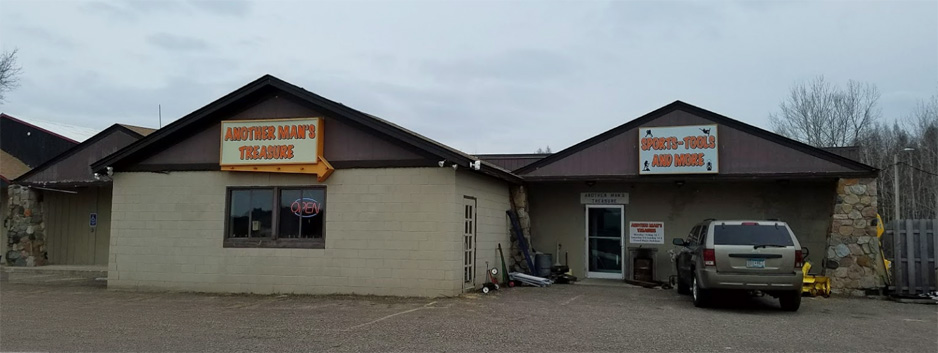
Thanks to the folks at Another Man’s Treasure, and to Mary Rinehart Erickson on Facebook!
The Medina Ballroom was built in 1956 by brothers Bob, Cliff, and Joe Raskob (along with friend Norm Vansion) near their home. The Raskobs saw a need for a place to dance in Western Hennepin County. The entertainment complex also included a bowling alley. In 1959 it was advertised as the “new Medina Ballroom” featuring a Teen Age Dance. Also playing was Whoopie John. In 1961, the Rock-o-Tones played at the Teen Age Dance. A 1967 ad indicates that it was heavy on the polka music. On June 17, 1974, the facility burned to the ground, killing two including the daughter of an owner. It was rebuilt, and remains in the family to this day.

Forest Lake – 1952-55. Probably open summers only
From Historic Twin Cities.com:
On November 15, 1924, Memorial Stadium, located on the campus of the University of Minnesota, was dedicated during the stadium’s inaugural game between Minnesota and the University of Illinois. Minnesota won the game as a decided underdog, defeating Red Grange and his Fighting Illinis 20-7.
Known as the “Brick House,” the stadium was home to the Minnesota Gopher football team, which won seven national championships during its 58 seasons there.
The postcard below calls the stadium “One of the largest in the country,” with a seating capacity of 52,000.
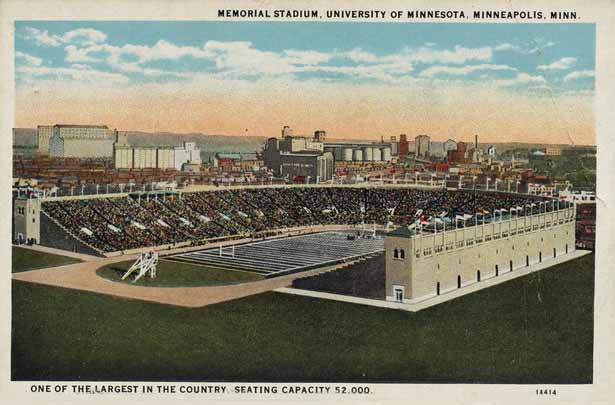
Postcard courtesy Johnny Hanson
MUSIC AT THE BRICK HOUSE
The stadium wasn’t an ideal music venue, but there were some notable events held here:
- Judy Garland helped celebrate Minnesota’s Centennial here in 1958.
- On September 21, 1971, there was a Blues and Folk Marathon at the Stadium.
- The Blues and Folk Marathon II was held on September 24, 1972.
- Marathon III, part of Welcome Week, took place at Memorial Stadium at the U of M on September 23, 1973.
STADIUM GONE
Again from Historic Twin Cities.com:
The Gophers played their last game in Memorial stadium on November 21, 1981, and the building was demolished in 1992.
The original brick entrance processional arch to the stadium was preserved, and when the McNamara Alumni Center was built on the same site, the arch was reassembled brick by brick and installed in the interior atrium over the entrance to a small museum.
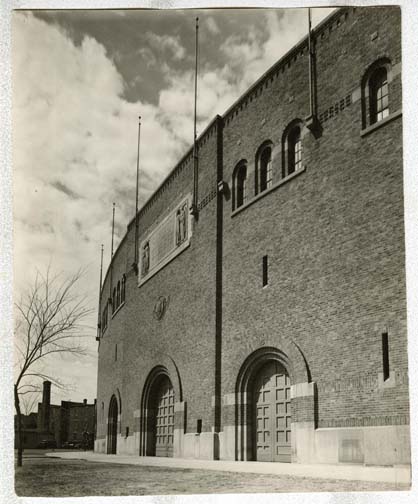
The Processional Arch – Photo from U of M Archives
The Mermaid is located at 2200 Moundsview Blvd. (Highway 10 and 35W) in Moundsview. It has grown to become a hotel, event center, bowling alley, and music venue.
You knew you were getting close to the Mermaid when you saw … The Mermaid!
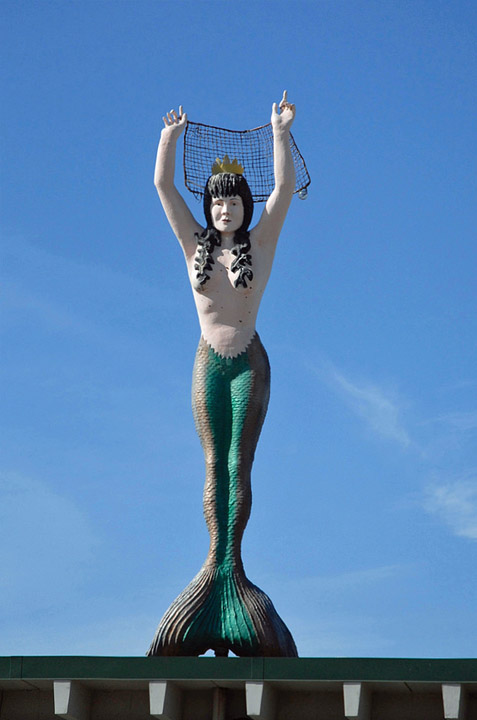
The Mermaid was a Country hotspot.
Here’s a story from Tom Campbell at minniepaulmusic.com:
It was spring in 1967 and Keith Zeller and the Starliners were playing seven nights a week at Papa Joe’s Northern Bar on West Broadway in Minneapolis. The Arsenal, a large munitions plant was located nearby. One day the club owners of the Mermaid contacted Keith Zeller and his band and wanted to know if they would play at their club on Friday mornings starting at 8:00 am. The club owners were aware that the night shift at the Arsenal got off work at 7:00 am and Fridays were paydays. They were banking on the idea that the workers just might enjoy hearing a live band after work.
Keith Zeller and company decided to give it a shot. Much to their surprise they discovered there was a market for live rock music at 8:00 am in the morning. The band soon discovered that playing seven nights a week and early Friday mornings was taking a toll on their sleep and the job at the Mermaid ended after a few weeks.
1969-1971: Country & Western music featuring Roger Mews and the Country Good Guys.
Here are a few ads from the Minneapolis Star that show some major acts:
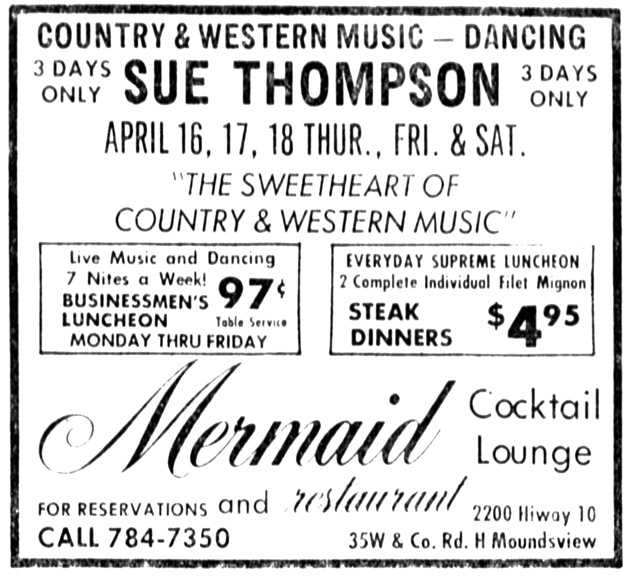
April 9, 1970
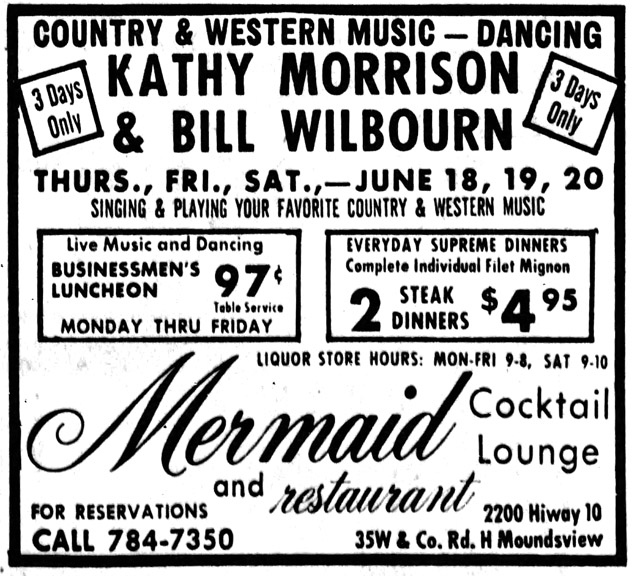
June 18, 1970
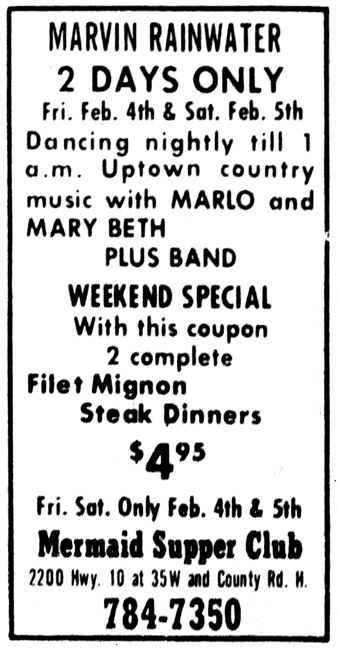
February 2, 1972
On February 6, 2018, the iconic Mermaid came down off of her rooftop perch. From her Facebook page:
The Mermaid Statue at the age of 54 had to retire due to being structurally unsafe. She had a very eventful fun life. She was born a 60’ blond at the Rubelson Sign Company in Columbia Heights, MN. She listened to a lot of bands in 1960s with Armory workers. She watched over bowling lanes built in ’70s. She was almost gone with the wind in 1975 when a 100 mile wind took her down. She was a constant “regular” at the night club Streamers in ’80s and in ’90s – she even got the nightclub renamed after her. She was a roadside attraction all her life. She will be missed by many… We are still The Mermaid.
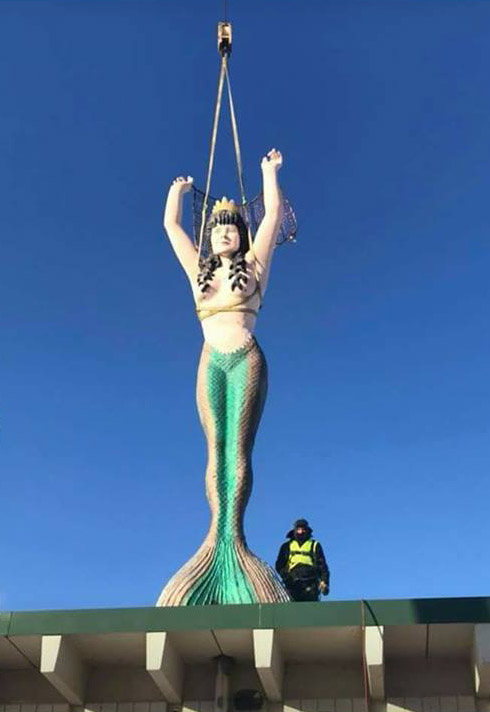
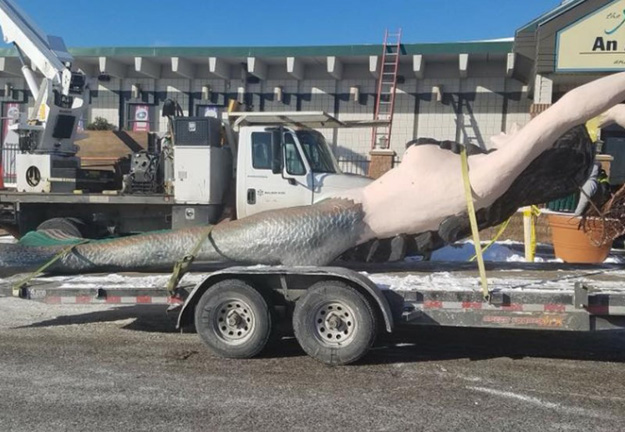
The Mermaid Statue is safe. She is in storage. We are currently assessing all our options to make her structurally sound again. Along with possibly placing her somewhere else on the property with approval of City of Mounds View. Thank you for all of your support. We will keep you updated.
Minneapolis’s Metropolitan Opera House was located at 322 Marquette Ave.
NEW PEOPLE’S THEATER
It was first called the New People’s Theater, built by Lac Stafford. Harry G. Carter, a Minneapolis architect, designed the Romanesque Revival building, and Lawrence Melvor designed the inside auditorium, which had two balconies and seating for approximately 1,500. According to Larry Millett, the designer neglected to account for a box office, so one was gerry-rigged under a staircase.
Its first manager was W.E. Sterling. It opened on March 24, 1894.
METROPOLITAN OPERA HOUSE
On December 16, 1894, the New People’s Theater was acquired by Jacob Litt, who renamed it the Metropolitan Opera House. The Metropolitan began taking the Grand Opera House’s bookings in October, 1895.
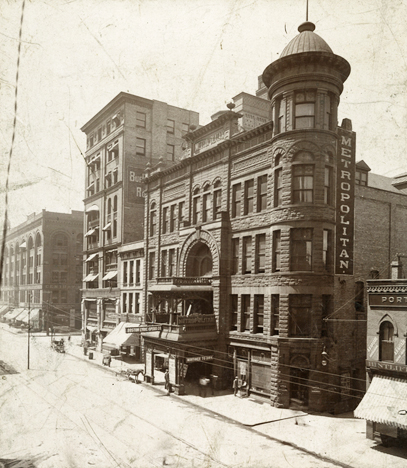
1989 Photo courtesy Minnesota Historical Society
THE KITTY GING MURDER
One of the most interesting stories regarding the Minneapolis Metropolitan Opera House revolved around the murder of Kitty Ging. On December 3, 1894, the lifeless body of Miss Catherine “Kitty” Ging was discovered on Excelsior Blvd. (then called Excelsior Road), just beyond Lake Calhoun in the vicinity of the Minikahda Golf Club. The Minneapolis Journal shouted “Foul Murder!,” elaborating that “A Bullet Hole in the Head Tells the Awful Story.” Although suspicion fell on her friend Harry T. Hayward, he had an airtight alibi, having been seen at the Minneapolis Opera House on the night of the murder.
Miss Ging, it turned out, had been murdered by the janitor of her Minneapolis apartment building (the Bellevue Hotel, aka “Ozark Flats,” located at 13th and Hennepin). The janitor acted at the behest of Hayward, who did it for Kitty’s insurance policies and for the experience of having someone killed. While the janitor drew a life sentence, Hayward swung from the gallows at the Court House (8th Ave So. And 4th Street) on December 11, 1895. In 1911, the death sentence was forever outlawed in Minnesota. For a full account, see the book Murder in Minnesota by Walter N. Trenerry, Minnesota Historical Society Press, 1962/1985.
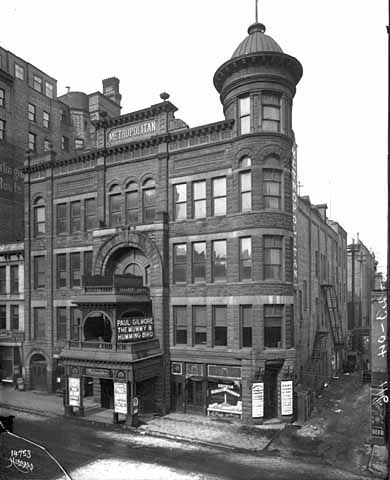
1904 photo courtesy MHS
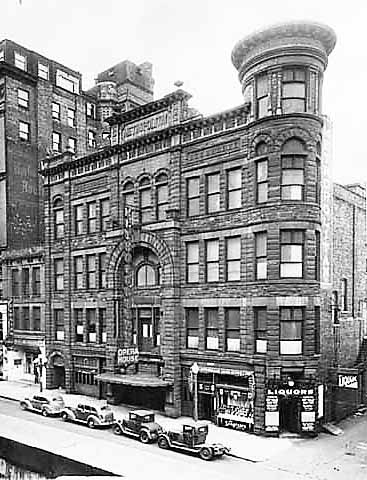
Metropolitan Opera House, @ 1935. Minnesota Historical Society
The Metropolitan Opera House was demolished in September 1937. After serving as a parking lot, the Sheraton Ritz Hotel was built on the site in 1963. The hotel was demolished in 1990, and the site is now the home of the 365 Nicollet apartments.
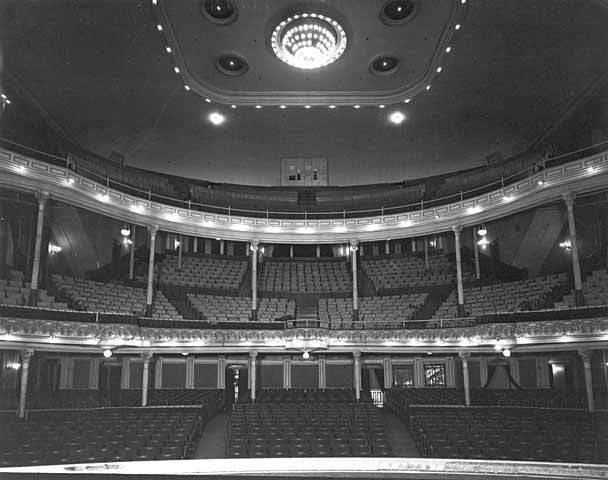
Interior of Opera House prior to Demolition. 1937 photo courtesy MHS
SOURCES:
Edgar, cinematreasures.org
“Alibis and Architecture,” Minneapolis Star Tribune, April 13, 2019
St. Paul’s Metropolitan Opera House was located at 100 East Sixth Street, between Minnesota and Robert Streets.
It was made necessary when St. Paul’s Grand Opera House on Wabasha Street burned down in 1888. It took two years to make ready, opening on December 29, 1890.
The new building was built in conjunction with an adjacent eight-story office building, both designed by James Reed. McElfatrick and Son of New York designed the inside of the theater, which had two balconies and could seat 1,800 patrons. The office building was very plain, but the Opera House was ornate, with a gold, ivory, and brown color scheme. A headline in the St. Paul Pioneer Press called it “A Splendid Theater, Leading in Many Respects, Anything of the Kind in America.”
St. Paul luminaries in attendance for opening night included railroad magnate James J. Hill, for a performance of a light opera called “Robin Hood.”
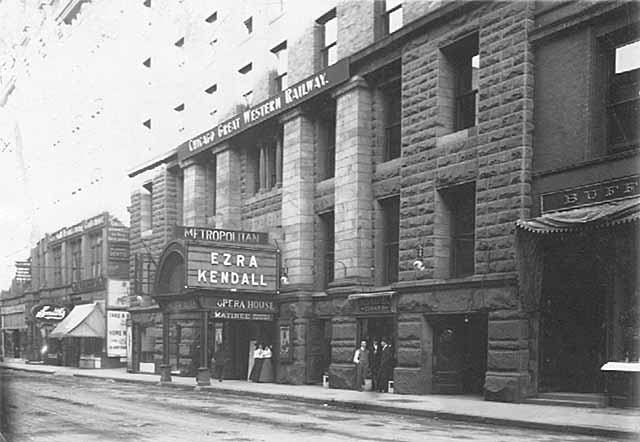
1900 Photo courtesy Minnesota Historical Society
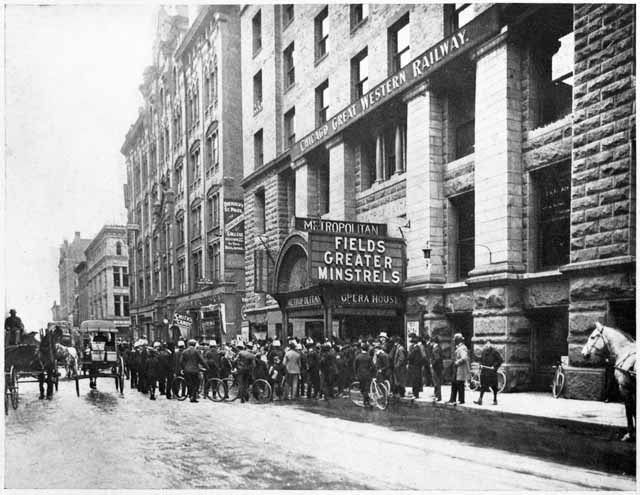
1902 Photo courtesy MHS
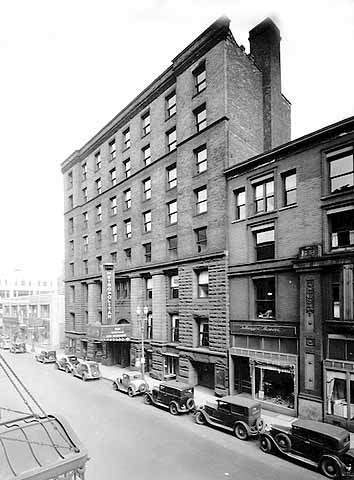
1936 Photo courtesy MHS
The theater and office building were demolished in 1936, replaced by U.S. Bank Center, built in 1975.
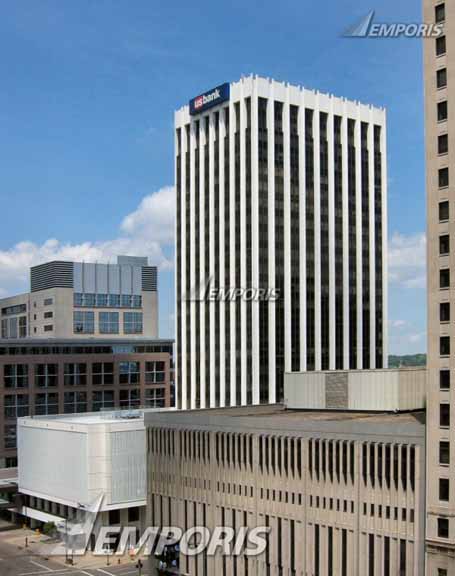
Source:
“Alibis and Architecture,” Larry Millett, Minneapolis Star Tribune, April 13, 2019
The Metropolitan Sports Center (the name was officially changed to just the “Met Center” in 1982) was built for the new National Hockey League expansion team, the Minnesota North Stars. Construction took a year, from October 1966 to 1967, at a cost $7 million. On October 21, 1967, the North Stars played their first home game against the California Seals. The multicolored spectator seats were in the process of being installed as fans arrived at the arena for the first time.
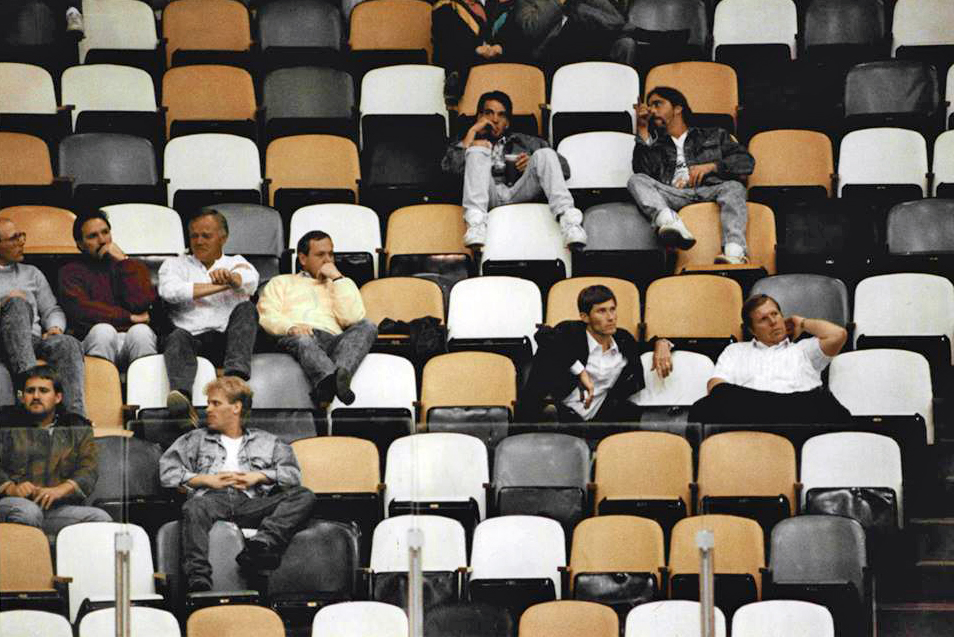
Photo courtesy Denny Craswell
The facility seated 15,000. It was home to the North Stars Hockey team from 1967-1993 and ABA’s Minnesota Muskies. The Met Center was considered to be one of the finest arenas in the NHL for many years, both for its sight lines and its ice surface. Among NHL players, the Met was known for fast ice, the best lighting, great locker rooms and training facilities.
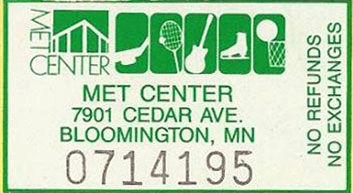
Ticket Image courtesy Josh McKeown
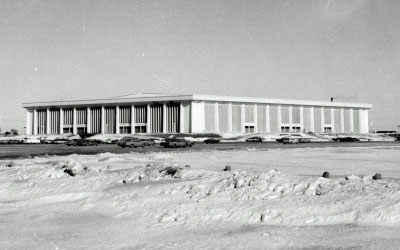
Photo copyright Bloomington Historical Society
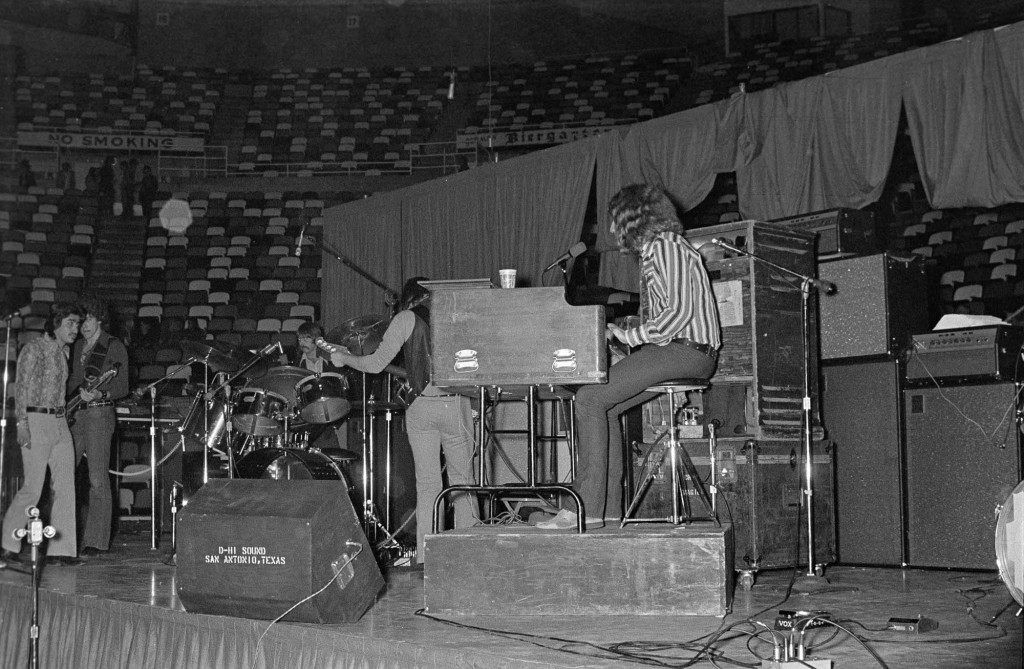
Crow warming up for a show in 1970. Photo courtesy Denny Craswell (on drums)
DEATH AT THE MET
Bill Masterson the only player in NHL history to die as a direct result of injuries suffered during a game, the result of massive head injuries suffered following a hit during a January 13, 1968, contest against the Oakland Seals.
Wikipedia gives this account:
He carried the puck up the ice at full speed, passing it off as two Seals defenders, Larry Cahan and Ron Harris, converged on him. Masterton was knocked backward in the resulting collision and landed on his head. Like most players of his era, he wasn’t wearing a helmet. Referee Wally Harris compared the hit to an explosion, adding “he was checked hard, but I’m sure it wasn’t a dirty play.” The force of the impact caused Masterton to bleed from his nose, ears and mouth. The impact of the hit caused him to lose consciousness before he hit the ice; according to some accounts, he briefly came to and muttered, “Never again, never again” before passing back out. He received treatment on the ice and in the dressing room before being rushed to Fairview-Southdale Hospital. Some 30 hours after his fall, on January 15, Masterton died without ever regaining consciousness.
Masterton’s death sparked a long-running debate in hockey about the merits of wearing helmets, as few NHL players did so in that time. Despite several efforts to mandate their use, it was 11 years before the NHL made them compulsory for all new players beginning in the 1979–80 season. In his memory, the NHL created the Bill Masterton Memorial Trophy which it has awarded since 1968 to a player who demonstrates perseverance and dedication to hockey.
FACEBOOK FACTS:
- The huge graduating classes of Bloomington high schools had their commencement ceremonies in the building.
- The teams stayed at the Marriott Hotel.
END OF THE MET
The last North Stars game was played in 1993. The team moved to Dallas to become the Dallas Stars. The scoreboard was crated up and moved to Dallas with the team. The seats, ice assembly, sideboards, and perhaps the doors were moved to the Sleepy Eye Ice Arena, which was built in 1994.
The building was demolished on December 13, 1994, in a series of three controlled implosions of the building and using the usual heavy equipment. Video of the implosion is on YouTube.
Metropolitan Stadium in Bloomington was built in 1956 in order to attract a major league baseball team to the Twin Cities. The Minneapolis Millers played here until 1960 when the Minnesota Twins came to town in 1961. The stadium hosted many concerts, the most memorable being the Beatles in August 1965 (see separate page). It was torn down in 1985 to make way for the Mall of America.
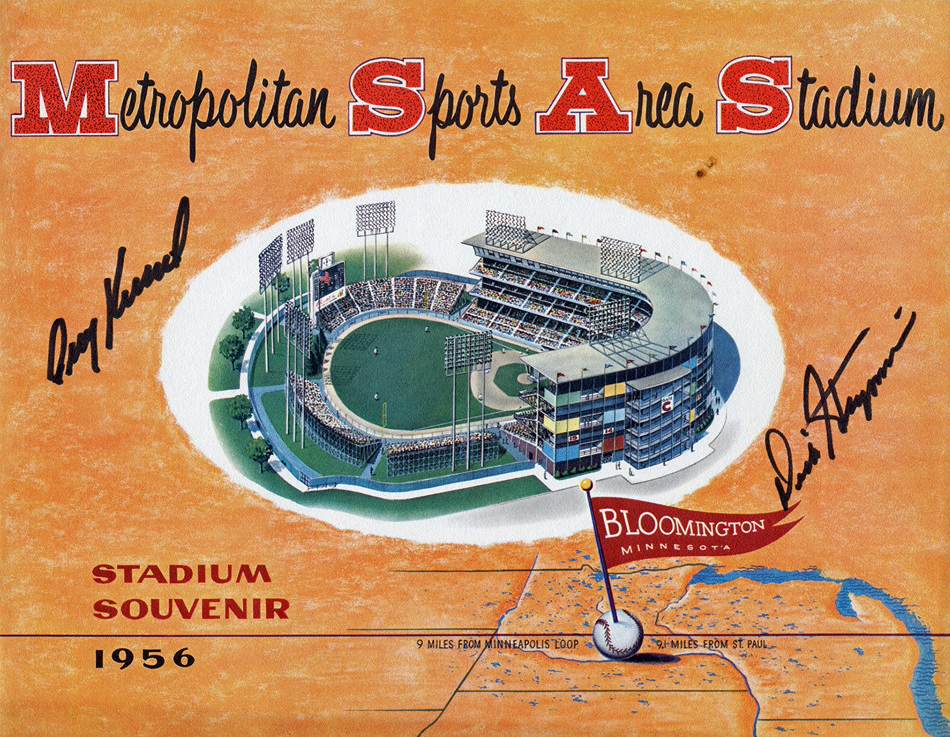
Please see the Golden Pheasant.
Michael’s was located on Highway 55 at Highway 100 in Golden Valley. In 1955 the address was 604 No. Lilac Lane.
Michael was Michael Krakes.
The restaurant had very distinctive decor featuring mounted fish and original works by local artists.
In 1963 the Caribbean cocktail lounge featured organ music. Lyman Brown played the organ at Michael’s for nearly a decade, reports his son.
Michael’s became Kozlak’s.
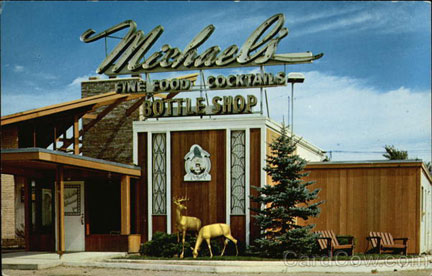
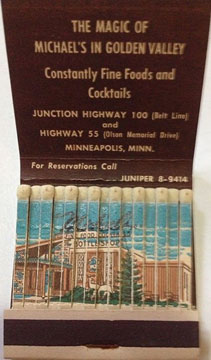
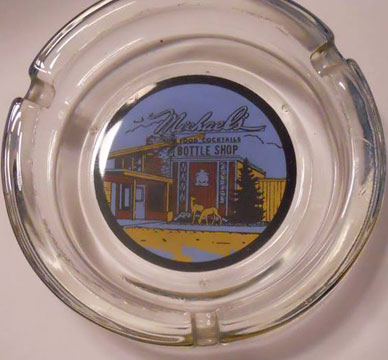
From the collection of Mark Youngblood
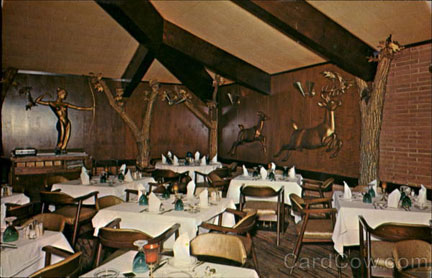
This page covers all the fun and hijinks to be had at 1639 University Ave. (one block west of Snelling) in St. Paul.
I would very much like to thank Erik Likes, manager at Ax-Man Surplus, which inhabits the building today, for giving me a tour back in 2019. He had a stash of postcards and other materials about Midway Gardens that staff had either found or that people had sent them, that he allowed me to photograph. I was so grateful for his interest in the history of his building, and his willingness to take the time to share it with me. In return, I bought a pair of cheap sunglasses!
1933
MIDWAY AMUSEMENT CLUB/MIDWAY GARDEN(S)
It is unclear when the Midway Garden nightclub took shape. (The name seems to have morphed from Garden to Gardens, and its original name was the Midway Garden Gay 90’s Stage Bar.) I’ll present evidence in chronological order to demonstrate the confusion.
This venue started in about 1933 as the Midway Amusement Club, apparently built by the Midway Amusement Co. In September 1933, the Minneapolis newspapers began reporting on bowling scores from the team bowling from the eight lanes in the basement. The location was just given as “Midway Amusement Club, St. Paul.”
An undated ad for the Midway Amusement Co., 1633-9 University Ave., only advertises the bowling alley: “Bowl Three Times a Day and Keep the Doctor Away.” It does give the critical bit of information that the manager was Clarence J. Walraff. On Saturday, February 18, 1933, Walraff was elected to the Board of Directors of the International Bowling Association. Despite their name, all officers came from Minnesota or Wisconsin. (Minneapolis Tribune, February 19, 1933)
Below are a couple of early matchbook from the place. They say only Midway Amusement Co., “operating the only air conditioned recreation center in the Twin Cities.” The back calls it “Midway’s Fun Factory, Featuring Bowling and Billiard Rooms, restaurant and night club, cigar counter and bar.” Neither of them have yet dubbed the night club the Midway Gardens.
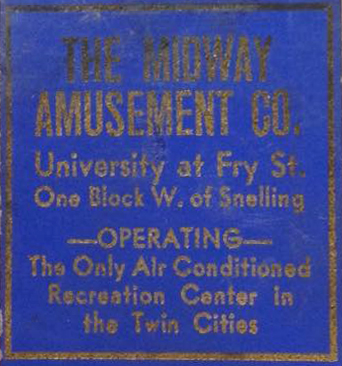
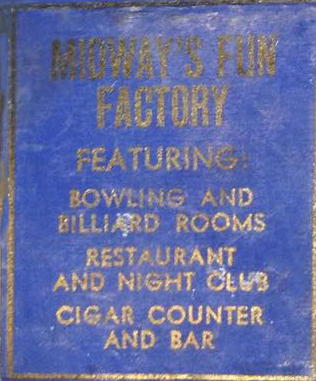
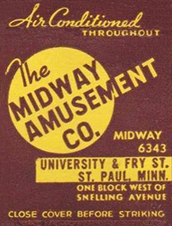
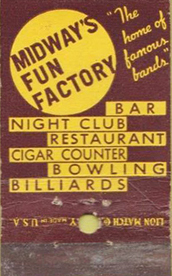
Both matchbooks are from the collection of Mark Youngblood.
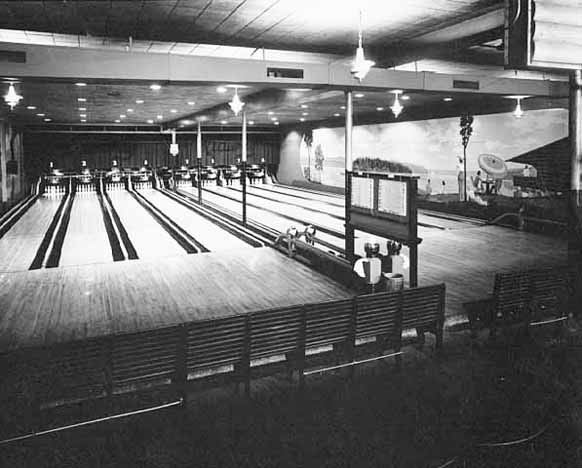
1940 photo of the 8-lane bowling alley, courtesy Minnesota Historical Society
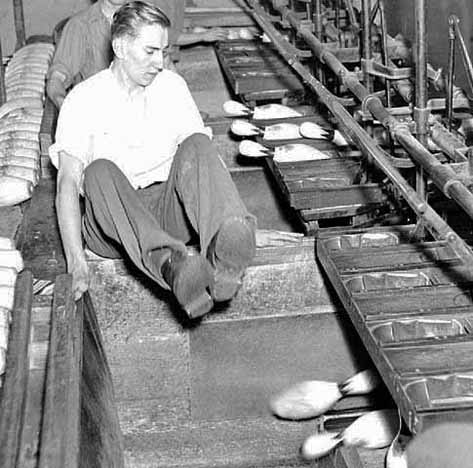
1937 photo demonstrating the hazardous work of pinsetting. Photo courtesy Minnesota Historical Society
Decades later, Ax-Man still had this list of the best pinsetters:
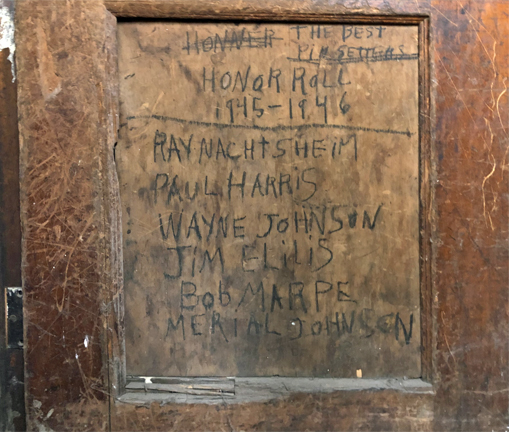
Courtesy Ax-Man Surplus
There were 13 billiard and snooker tables.
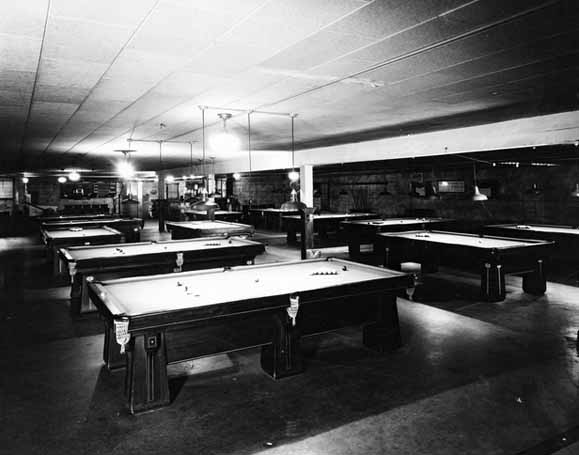
1940 photo courtesy Minnesota Historical Society
This bar says Midway Amusement. MHS dates the photo 1940, but the bar was up and running by November 1934 at least. Whether it was upstairs with the restaurant, downstairs with the bowling alley, or adjacent (the address was 1633 University), it was certainly associated with the Midway Garden.
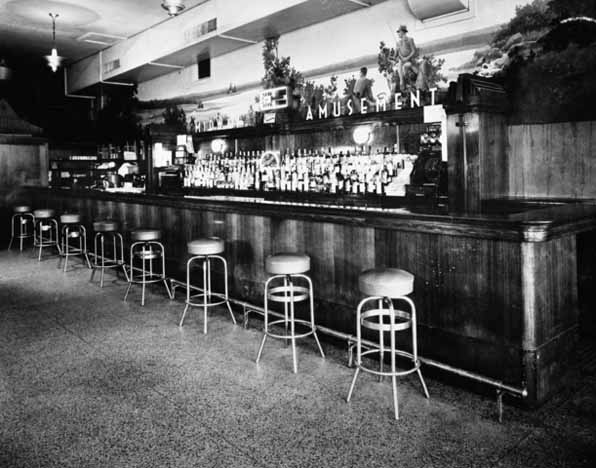
Photo courtesy Minnesota Historical Society
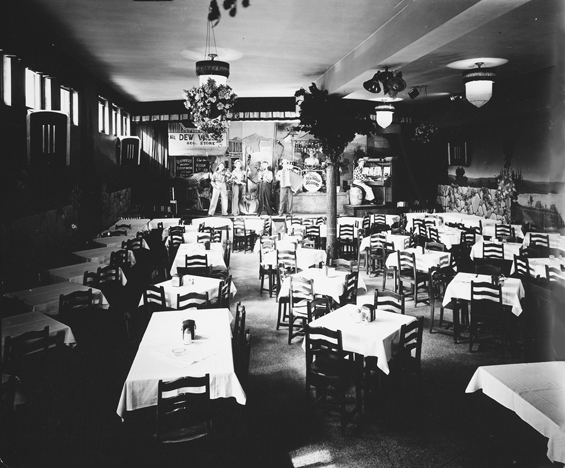
1940 Dining Room photo courtesy Minnesota Historical Society
The undated image below from a matchbook doesn’t really help – or does it? On the left there is a bar with tables, and on the right is just a bar. So it looks like they were in the same room.
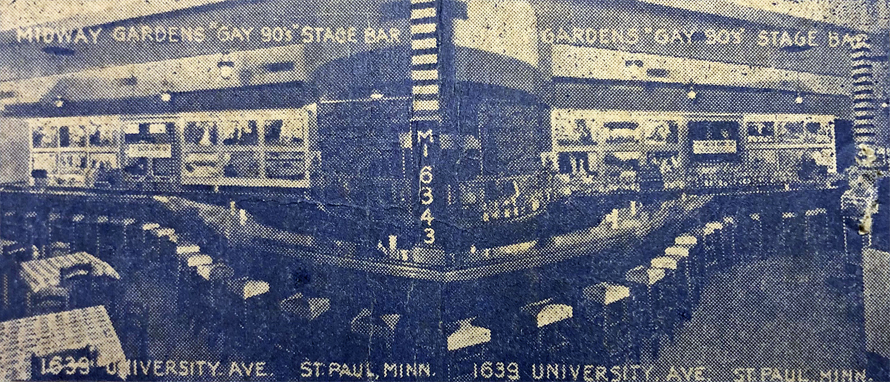
Image courtesy Ax-Man Surplus
1937
Cedric Adams first mentioned Midway Garden in his column in 1937, noting that a blind traveling orchestra called the Arions were performing at the club for the month of April . (Minneapolis Star, April 1, 1937)
FREDDIE FISHER
Freddie Fisher and the Schnickelfritz novelty band, “The World’s Most Unsophisticated Band,” was close behind, again reported by Adams at Midway Garden (July 7, 1937). The band got attention in Billboard and Variety.
In September 1937, Rudy Vallee was in town and caught the group’s performance. He was so impressed that he ran up on stage and offered the band a part in his next movie. By November 1, 1937, they were off to Hollywood. On June 1, 1938, Warner Brothers’ “Gold Diggers in Paris.” premiered in New York City, featuring the Schnickelfritz Band.
Freddie started his comedy band in Winona (at the Sugar Loaf Tavern, reported Adams) in 1935 and was well-known in the Twin Cities in the ’30s and ’40s. In the late ’40s he moved to Aspen, where he died at age 62 in 1967. (Minneapolis Tribune, March 29, 1967)
This might not be too readable, but it’s the ultimate primer on what the band’s all about. Sounds like a precursor to Spike Jones?
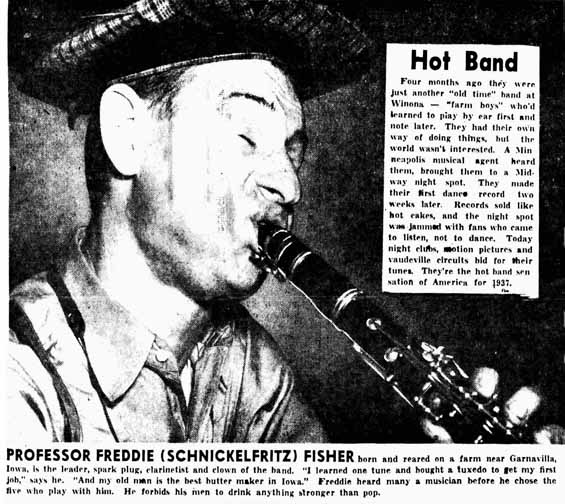
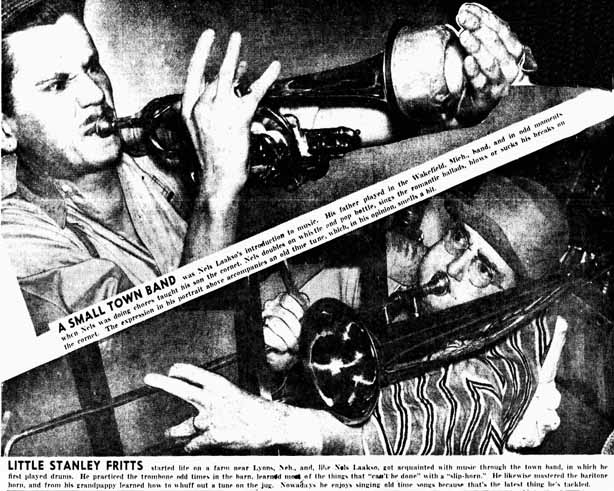
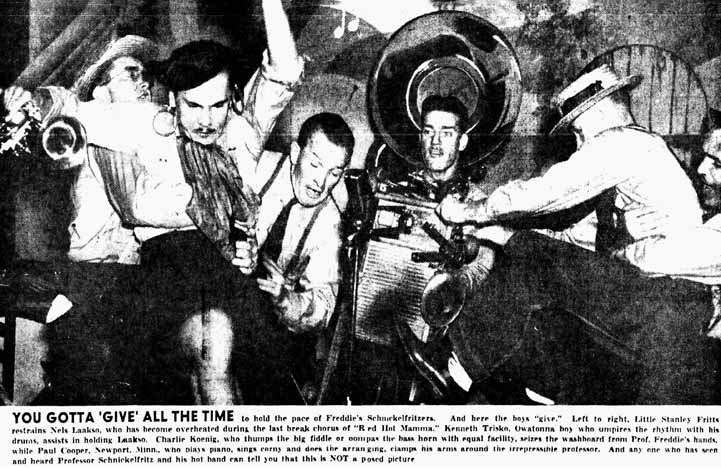
In the Star’s September 17, 1937, issue, most of a page was dedicated to the partying of the upper class at the Midway Gardens before they went off to their Ivy League schools out east. Prep and Finishing schools were reported, as well as comings out. They ate fried chicken. With their hands.
In October 1937, there was reference to the Midway Amusement Co., a place to pick up tickets to other shows.
On Sunday evening, November 14, 1937, the Midway Amusement Club Orchestra was broadcast over WTCN radio.
1938
The next orchestra was called the Rodeoliers. An ad placed in March 1938 urged people to get acquainted with Mrs. O’Leary, the club’s nationally famous musical cow.
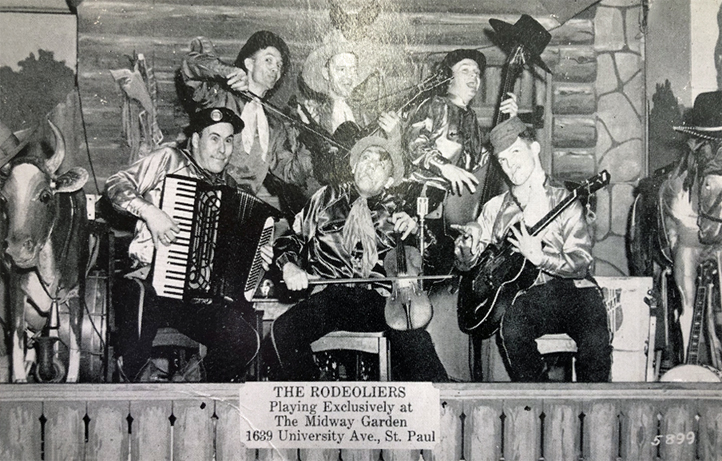
Image of postcard courtesy Ax-Man Surplus
The Rodeoliers apparently went on to New York, and in August 1938 the new band was Darrell Fischer and the Minnesota Lumberjacks.
But what do we make of this? One of those Seasons Greetings ads reads, “Midway Amusement Co. Announces the Midway Garden (Night Club)”
1940
DEW VALLEY ACORNS
Goofy bands were the rage, and New Years Eve 1939 offered up the “Dizziest and Daffiest band that ever hit the Twin Cities,” in Fiddle Bow Bill and His Dew-Valley Acorns.
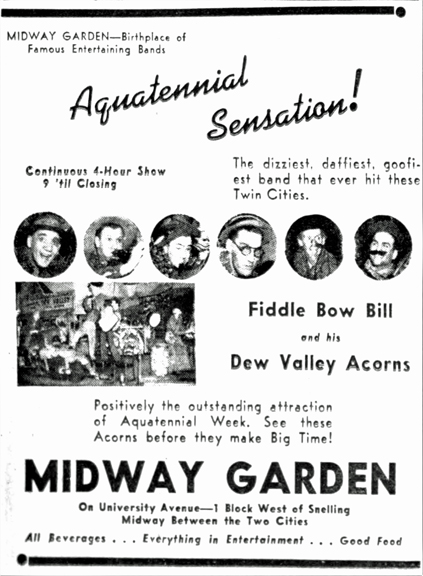
July 22, 1940
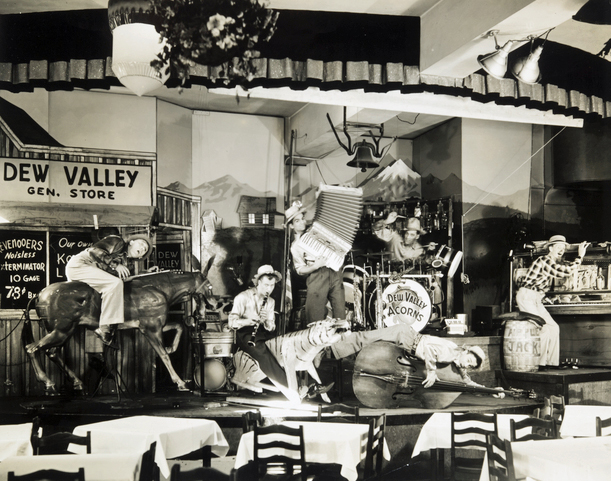
1940 photo of Dew Valley Acorns, courtesy Minnesota Historical Society
On November 10, 1940, an ad celebrated the group’s 355th performance at the Midway Garden.
1941
In November 1941, something new was added – a melodrama that incorporated old songs that everyone knew.
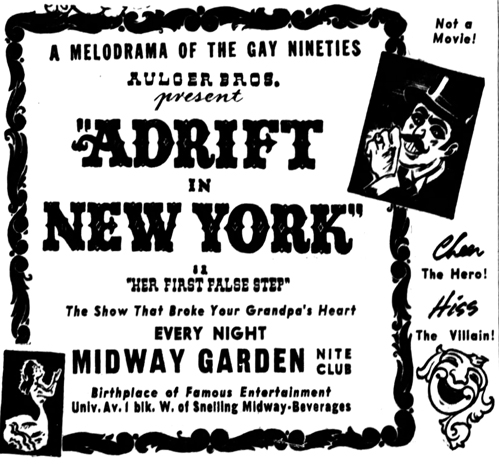
Minneapolis Star, November 2, 1941
But come December 1941 the corn returned in the form of Jerry Harstad and his Korn Huskers.
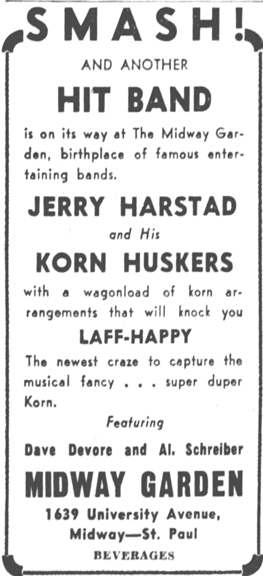
December 21, 1941
1942-1945
The presence of uniforms makes me think these photos were taken during World War II:
The photo below is from Jim Bloomfield. “Pictured on the right are my parents, Arlene Olsen and Joel Bloomfield. On the left is my dad’s brother, John Bloomfield and his soon-to-be-spouse Virginia Banning.”
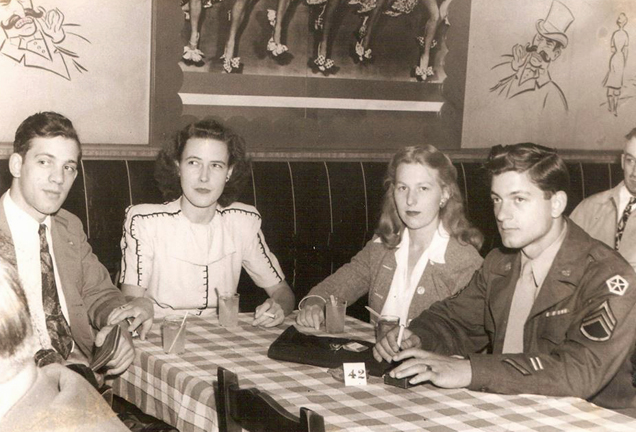
Photo courtesy Jim Bloomfield
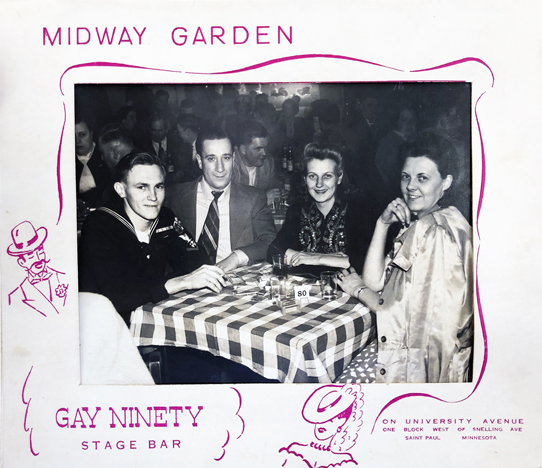
Photo courtesy Ax-Man Surplus
1945
Things slowed down during the War, but a big ad in May 1945 announced that the hilarity was back in business.
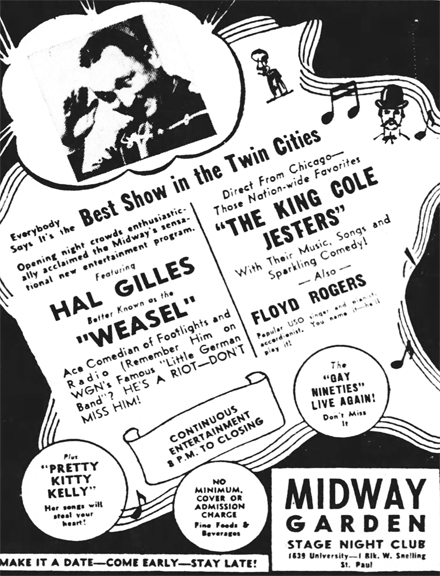
May 25, 1945
The Dew Valley Acorns were back in 1945.
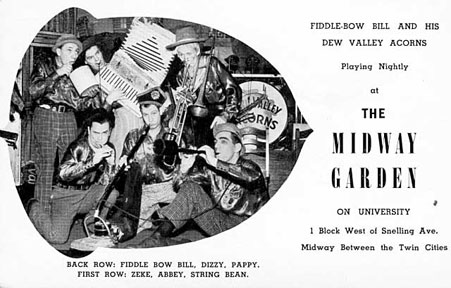
These crazy guys played nightly in 1945. Photo courtesy Minnesota Historical Society
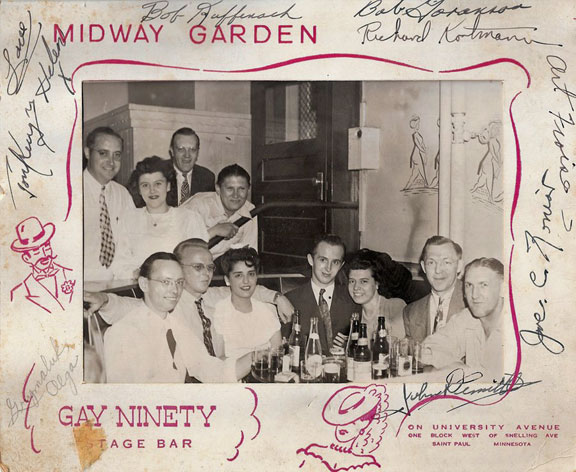
Photo posted on Facebook by Mike Mason
1948
In December 1948, you could spend your New Year’s Eve with the Korn Kribbers, yet another hokum comedy band. They had been at the club in February 1946 as well.
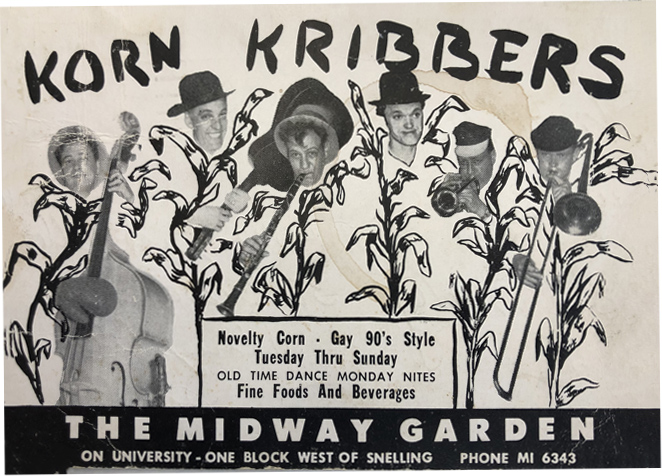
Image courtesy Ax-Man Surplus
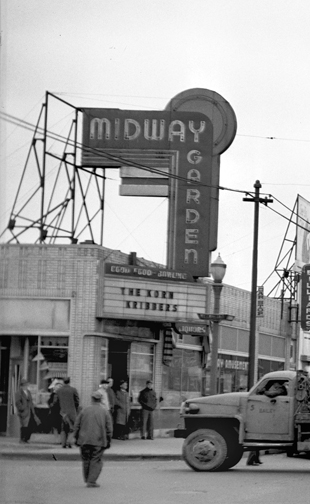
1948 Photo of sign courtesy Minnesota Historical Society
1949
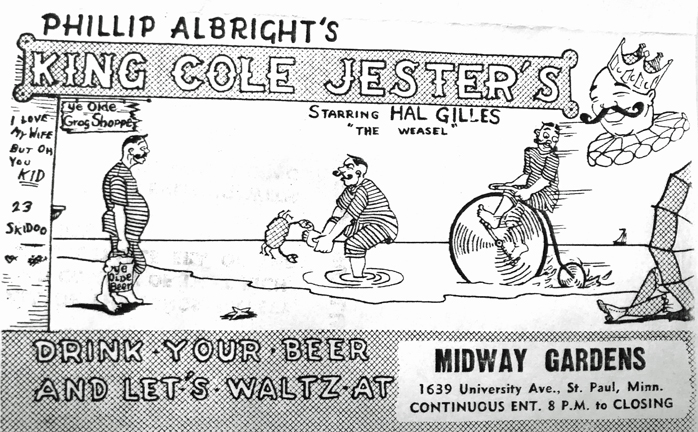
1949 Postcard courtesy Ax-Man Surplus
1951 – 1952
In July 1951, the Midway Garden may have gone Country/Western, which is not at all like Cornball, in the early 1950s. Ardis Wells would go on to rule the front bar at the Flame Cafe once it took the plunge and went Country in 1956.
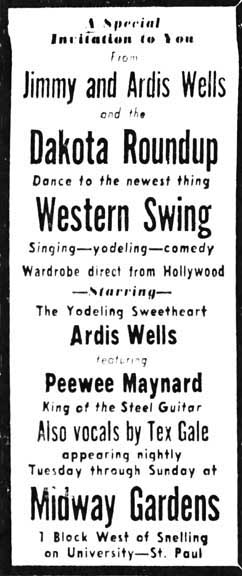
Minneapolis Star, January 22, 1952
1960
END OF THE GARDENS
A notice was posted on May 1, 1960, that the Midway Garden was “Quitting Business” and that there would be an auction on May 3. For sale were restaurant and bar fixtures, and an 8 lane bowling alley. Auctioneer David H. Levine began using the building to auction off other lots, with ads running until July 21, 1960.
1961
FAMILY PLAYLAND
On January 17, 1961, the Star announced that Family Playland, a family recreation center, had opened in the building.
1965
MERCHANDISE CLOSEOUTS
In September 1965, General Products Corp. offered closeouts of all sorts of merchandise in wantads entitled “ATT. WAGON JOBBERS.”
1966
AX-MAN
Finally, the first ad for Ax-Man Surplus appeared, again in the wantads. The ad was for Melmac dinnerwear, sold cheap.
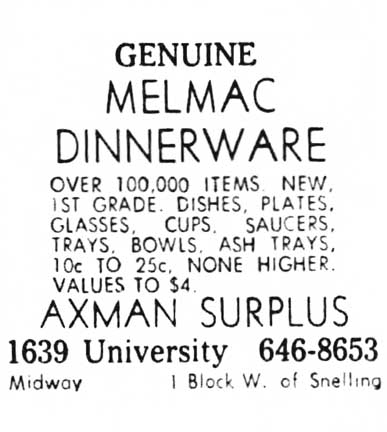
Minneapolis Star, March 17, 1966
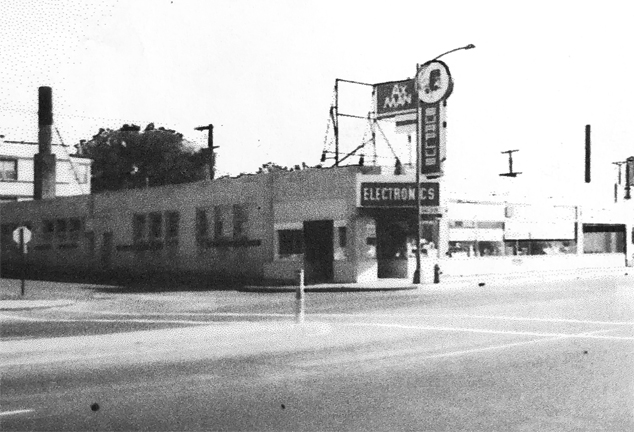
Photo from September 1966, courtesy Ax-Man Surplus
As of 2019, Ax-Man was still in the building, and respectful of its history as the former home of Midway Garden!
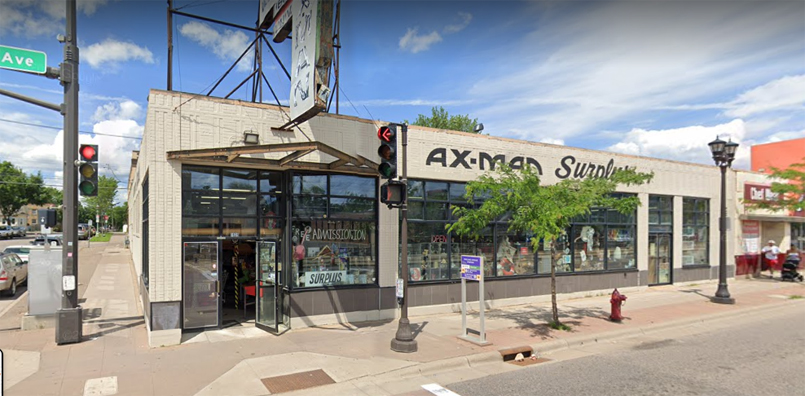
2019
And Ax-Man is still using the Midway Gardens sign:
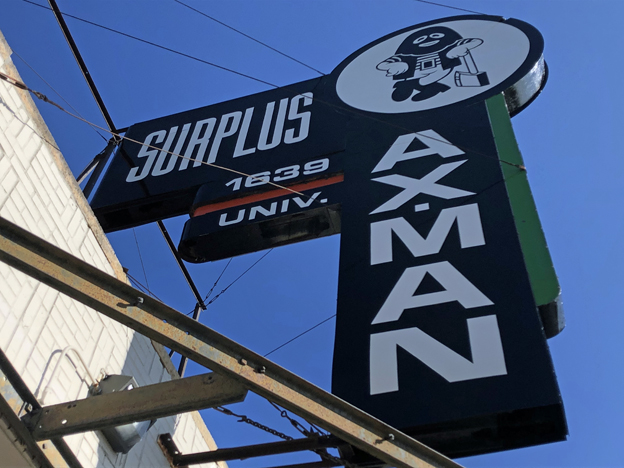
2019
WHAT’S LEFT?
Believe it or not, when I was given my tour of the place in 2019, there were still vestiges of Midway Gardens. Behind a dumpster was some long-ago foliage from the long-ago garden where the people in their finery danced to orchestras or laughed at the cornball but talented musicians who came from the farm.
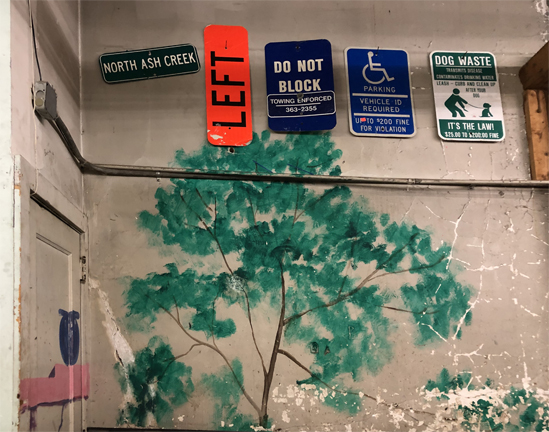
2019
To the left is a very narrow doorway to the basement, where the men bowled and played snooker and smoked fat cigars and solved the problems of the world and competed with teams from Hamm’s and Coca Cola and Schmitt’s. There was no light and it was too dangerous to go down, unfortunately. But my imagination went down to the bowling alley, where I interviewed the ghosts of those champion pinsetters. Brave men, all.
There were two Midway Stadiums, both gone now.
FIRST MIDWAY STADIUM
Wikipedia:
The first Midway Stadium was the home of the St. Paul Saints from 1957–1960. It was located at 1000 North Snelling Avenue, on the east side of that street. It was built with just a small uncovered and presumably expandable grandstand. It was intended to compete with Metropolitan Stadium for attracting a major league baseball team, but the already-larger capacity of “The Met” doomed Midway Stadium. It was abandoned for professional baseball once the Twins arrived in 1961 and displaced both the Saints and the Minneapolis Millers. It was used for minor events and as a Minnesota Vikings practice field for the next 20 years, and finally demolished in 1981 to make way for the Energy Park. That development, with all new streets and various buildings, rubbed out any trace of the ballpark’s existence.
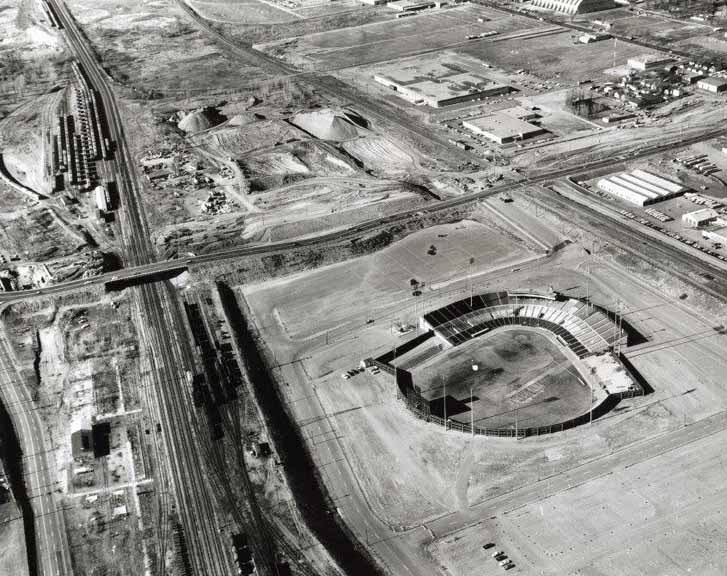
1964 photo courtesy Mn/DOT – Ramsey County Historical Society
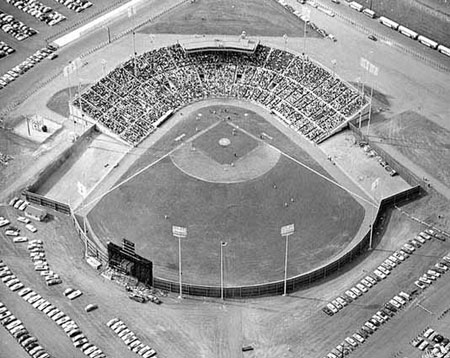
1967
OPEN AIR CONCERTS
Midway Stadium was best known for a series of so-called “Open Air Concerts.”
Chicago, the Doobie Brothers, and Kansas appeared at Midway Stadium on August 22, 1974. The concert was promoted by Dick Shapiro.
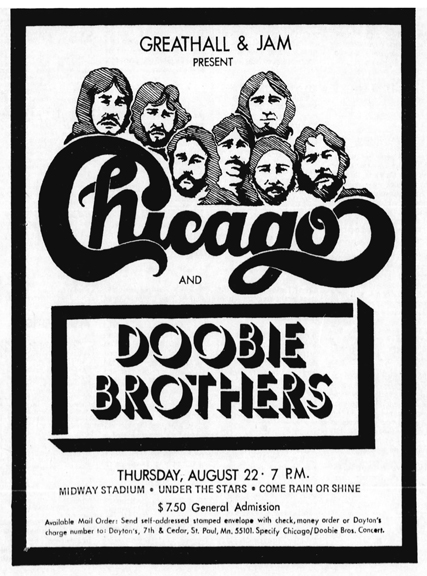
Minneapolis Tribune
Oddly, an article about the concert the next day described lots of things but failed to mention who was performing. It did say that 27,500 people attended, and that all bottles and cans were confiscated at the gate. Security men hired by Greathall Productions said “Even a can of Coke can turn into a dangerous projectile.” As the word got out, concert-goers chugged their beer before it got tossed. Patrons were not checked for pot, other drugs, or weapons. The concert was delayed for two hours because of the stop and frisk, but “on the whole, people seemed to be having a good time listening to the music, cuddling with their dates and enjoying the cool evening air.”
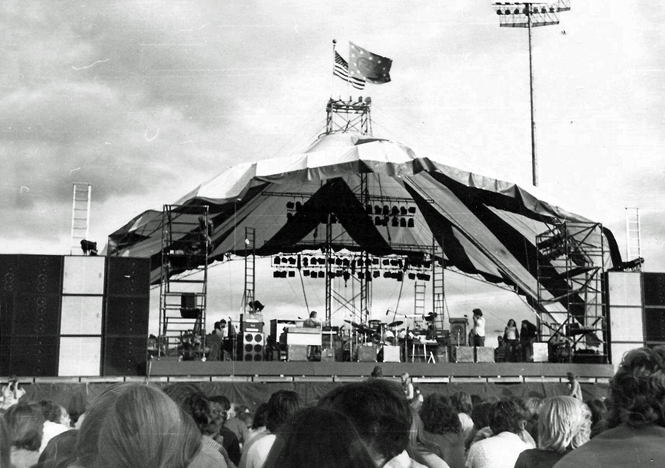
Photo by Marty Starr
Michael Anthony’s review was much more specific. He gave the attendance as 27,037, a record for the stadium. The St. Paul police and the managers of the stadium were
wary of possible violence (such as that which occurred at the last big Midway concert the summer of 1971), and covered the concert with nearly 100 uniformed officers, a number of plainclothes narcotics agents and four dogs. In addition, the police department recorded crowd behavior on video tape from the roof. No arrests were made.
One member of the crowd recalled opening band Kansas “getting a poor reception. They were pretty unknown at the time and I don’t think the crowd knew what to make of them.” Another didn’t remember them at all. Many people were still trying to find their seats during their set.
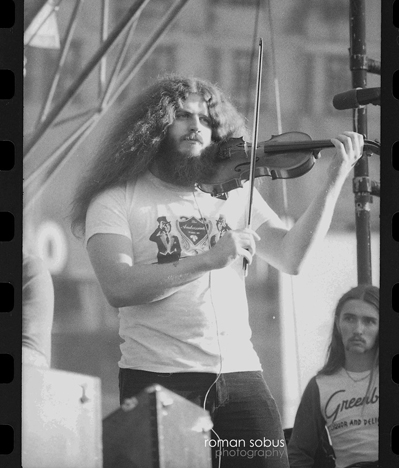
Kansas’ Robby Steinhard. Photo courtesy Roman Sobus
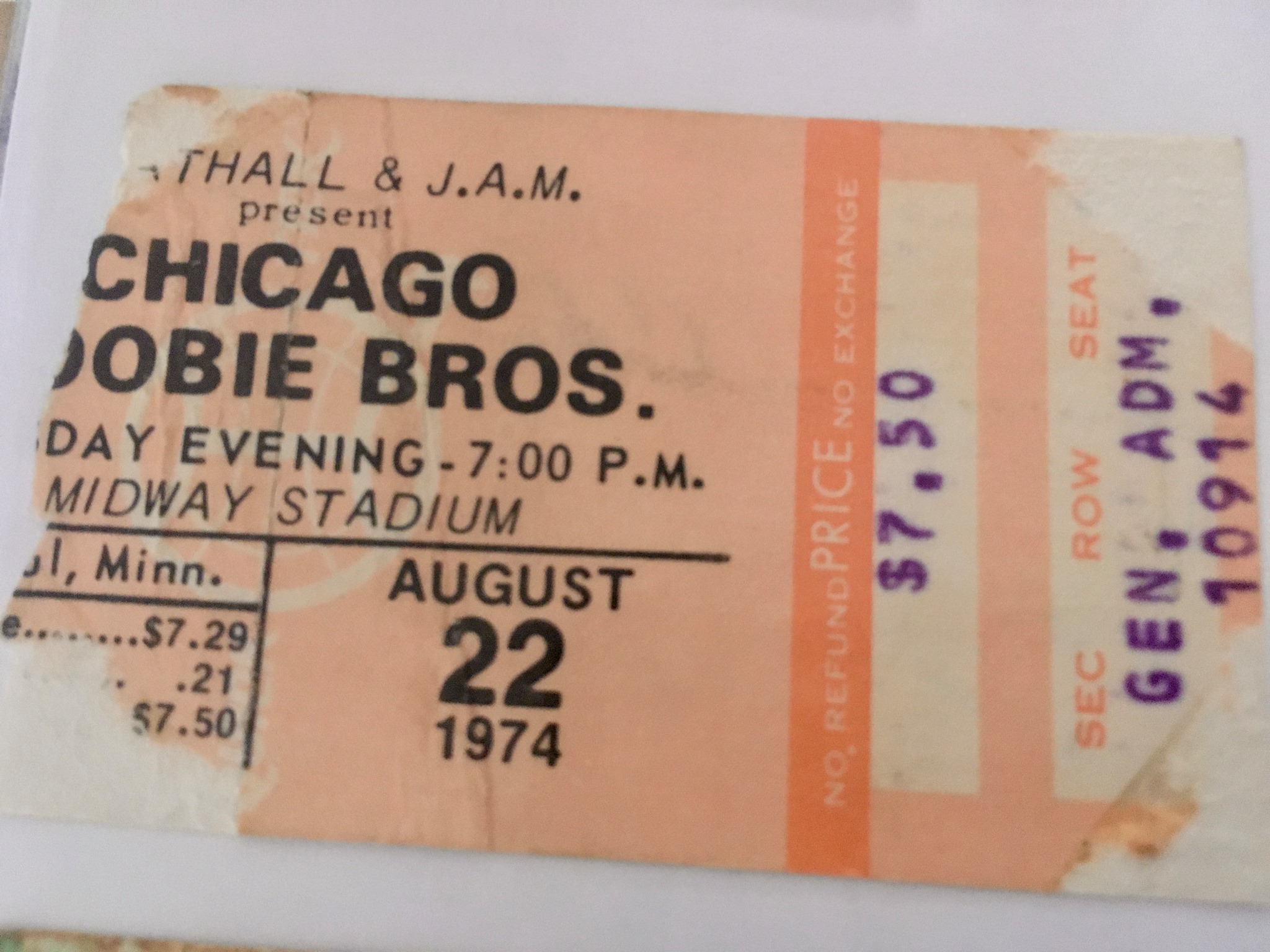
Ticket stub image courtesy Karen Thomas
The Doobie Brothers were next. Anthony felt the need to write, “The Doobie Brothers, none of whom are actually brothers or named Doobie (Doobie is California slang for “joint”)…” They played for 85 minutes and “Lead singer Tom Johnston was flat much of the time.”
While Chicago was setting up, a female streaker ran across the stage “and was never seen again.” Otherwise Anthony didn’t have much to say about the band.
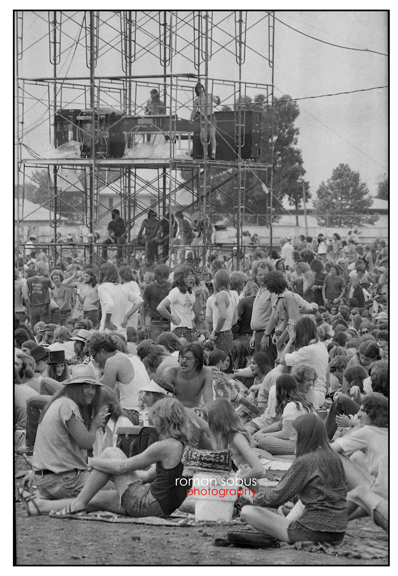
Photo courtesy Roman Sobus
SECOND MIDWAY STADIUM
Wikipedia:
The second Midway Stadium opened in September 1982 at roughly half the size of its namesake. It was located at 1771 Energy Park Drive. That’s on the north side of that road, just west of Snelling, complemented by the Burlington Northern tracks to the north just beyond left field. Thus it was about a mile west of the first Midway Stadium site. The ballpark started out in life as Municipal Stadium. It was home of Hamline University’s baseball team. Despite its baseball configurations, some small private schools in St. Paul played football games at Midway in the fall. When Mike Veeck and Bill Murray revived the Saints and also the independent Northern League in 1993, they set up shop there, at the soon-rechristened Midway Stadium. Midway Stadium was also used, occasionally, for rock concerts and other events. In April 2014 it was announced that pioneering alternative rock band The Replacements would hold a hometown reunion concert at the venue on September 13, 2014.
The Saints’ slogan is “Fun Is Good” and Mike Veeck has proudly declared that Midway Stadium is “The ugliest ballpark in America!”[ Mike’s late father, Bill Veeck, Jr. is a well-known baseball owner and counts one of his accomplishments as planting the ivy at Wrigley Field.
2014 was the final season for both Hamline and the Saints at Midway Stadium. Both teams moved into the new ballpark CHS Field in time for the 2015 season. Midway Stadium was torn down in June 2015. The 12-acre site will be used for an office or warehouse development, which is in line with the industrial area that surrounds the stadium.
This page covers two venues at the same location:
Miller’s Cafe
Colony Club
MILLER’S CAFE
John W. Miller ran a chain of cafeterias in Minneapolis, St. Paul, Duluth, and the Iron Range in the 1920s. In 1922 the/a St. Paul location was at 439 Wabasha.
Joined at the Hip says that in 1941 the Cafe was on St. Peter Street, and Wally Olson’s band played for more than a decade. Indeed, in September 1945, there was a Miller’s Cafe at 492 St. Peter Street. In November 1949,the address was cited as 488 St. Peter Street and the owner was identified as George Miller. An article from February 1950 said that the bar had lost its license and that the address was actually 492 Wabasha.
COLONY CLUB
In November and December 1952 we see 492 Wabasha as the home of the Colony Club.
The first big act was the Harmonicats, who opened on November 3, 1952.
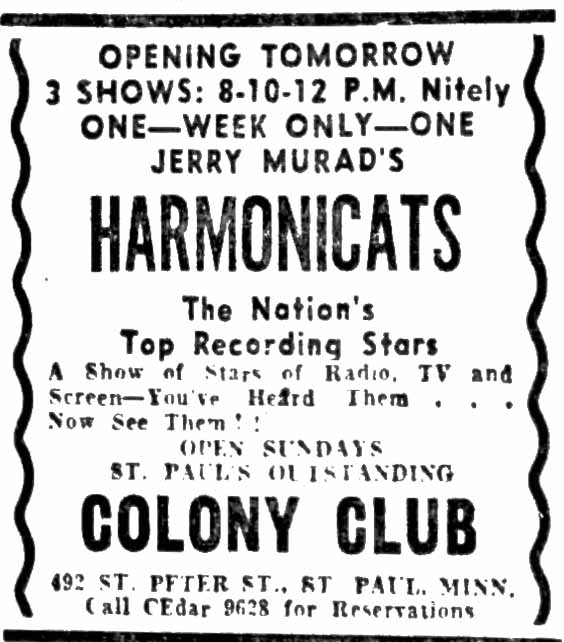
Minneapolis Tribune, November 2, 1952
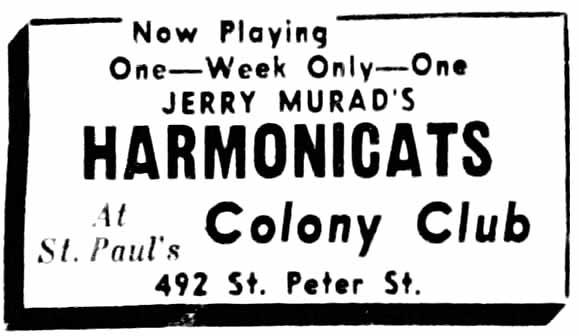
Minneapolis Tribune, November 4, 1952
Will Jones remarked in his entertainment column that the club was hiring big acts that used to make Minneapolis a regular stop. (Minneapolis Tribune, November 7, 1952)
Singer Jan August was next, and she required a $7,000 piano for her act. It had to be rented from… Minneapolis.
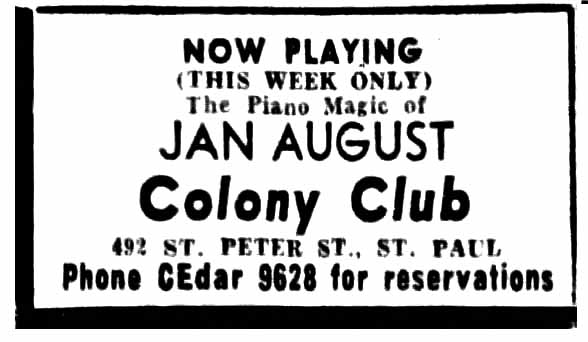
Minneapolis Star, November 11, 1952
In December 1952 the club hosted Bill Lawrence, the singing star of Arthur Godfrey’s show.
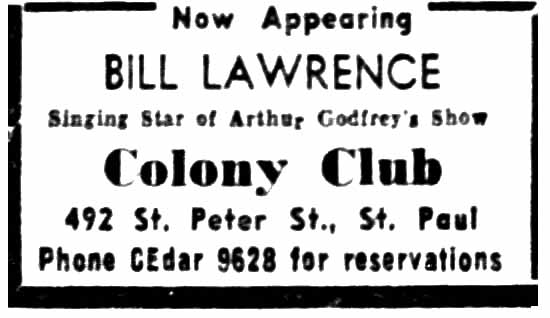
Minneapolis Tribune, December 6, 1952
Apparently the club didn’t make a go of it – searches under Colony Club and the address rendered no hits except for Colony Club shoes or the club in New York.
Also see this page for another Colony Club in the area.
This page covers these venues:
- Zephyr Cafe
- Miller’s Coaches
- Night Train
- Silver Coaches
ZEPHYR CAFE
The Zephyr Cafe was located at at 289 Como Ave. in St. Paul.
These were two 1887 Pullman coaches that once graced Northern Pacific’s Chicago-to-Seattle line, transformed into a tavern. Wheels and other gear were removed, so the cars would stay put. Photos from 1937 show them being constructed. The sign “No Dancing” probably meant that there was music of some kind, even if from a juke box, but that the owners didn’t have the proper license for dancing. (There was another Zephyr Cafe at 444 Wabasha in 1941, where there was entertainment.)
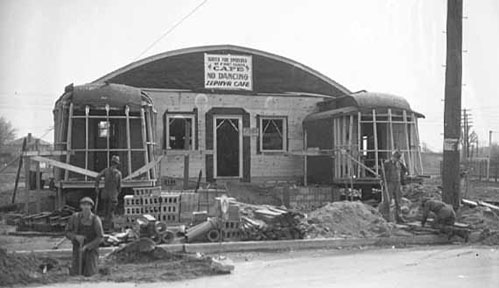
1937 photo courtesy Minnesota Historical Society
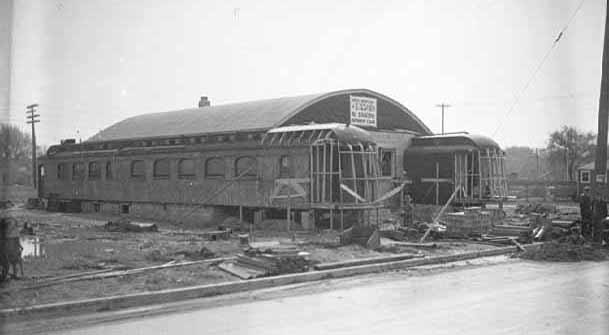
1937 photo courtesy Minnesota Historical Society
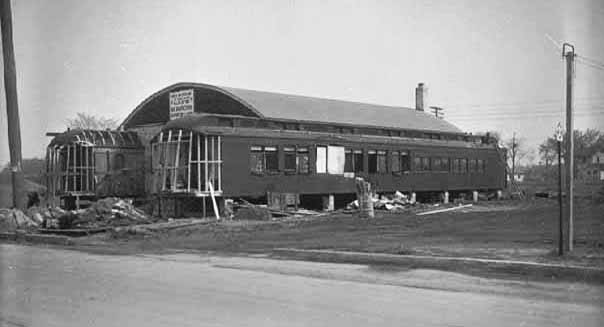
1937 photo courtesy Minnesota Historical Society
MILLER’S COACHES
Over time the place became Miller’s Coaches, where railroad and steelworkers flocked for a drink after work. Apparently there they played old time music and polkas.
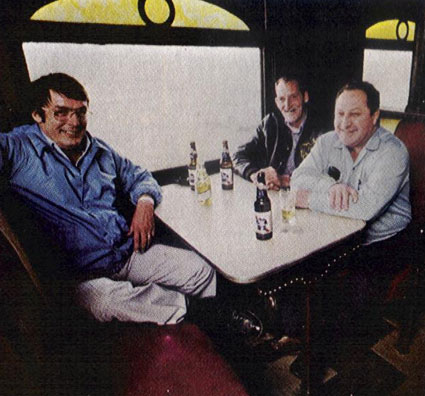
Patrons enjoying a beer, 1979
NIGHT TRAIN
An article by Jane McClure tells us what happened to Miller’s Coaches:
In 1981 Millers Coaches was sold to new owners. [Ron Sodermeyer, per Facebook] What had been a working-class spot was transformed into the swanky Night Train. About $250,000 was spent on new art deco décor. South African mahogany woodwork was refinished and brass luggage racks were polished. Neon tubing and ferns were also part of the decor. The 75-foot-long mahogany bar in one of the coaches was restored. The other car was transformed from a humble dining car to comfortable booths.
Those owners were only around for a couple of years, selling to Cathedral Hill restaurateur Leo Gadbois. He added a sunroom and jazz music.
On July 14, 1985, fire broke out on the roof, started in a neon sign transformer. The club suffered little fire damage, but was was heavily damaged by smoke and water. It was closed when the fire broke out and no one was injured. The fire was confined to the roof and a 15 ft. wide attic of the room that joined the two coaches. Damage was estimated at $31,000. At first Gadbois said that the club may reopen in three to four weeks. (Minneapolis Tribune, July 16, 1985)
But then he said his insurance company had gone bankrupt, and he transferred his liquor license to another bar. The Coaches sat boarded up for years. They were eventually purchased by a private owner and taken out of the city.
THE SILVER COACHES
Mark Hebert reports that it had an almost twin, Silver Coaches, about two miles away.
2900 Dupont Ave. So. In 1928 this was a roller skating arena, with band music every evening and Sunday afternoon.
THE KENWOOD ARMORY
The predecessor to the Minneapolis Armory was located at present-day Kenwood Parkway and Lyndale Ave. It was built in 1906, dedicated on January 8, 1907. With its castle-like fortresses, it certainly looks formidable.
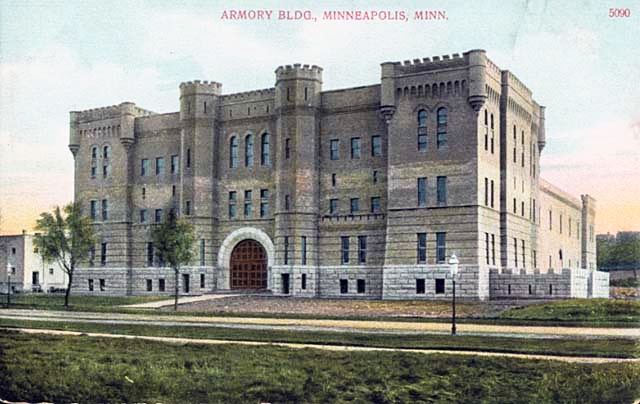
1907 Photo Courtesy Minnesota Historical Society
In addition to being used as the home of the National Guard, it was the site of the nascent auto shows of the turn of the last century. The photo below comes from the University of Minnesota and also dates to 1907.
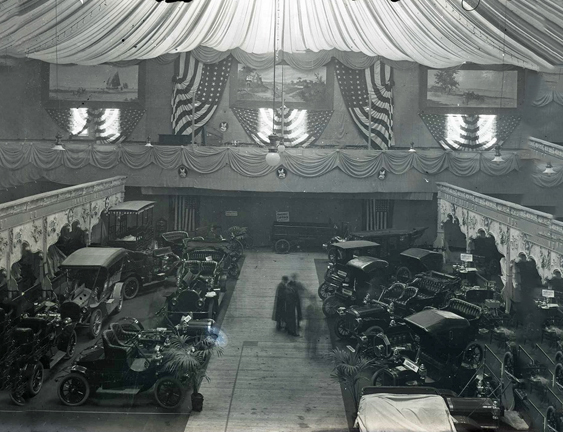
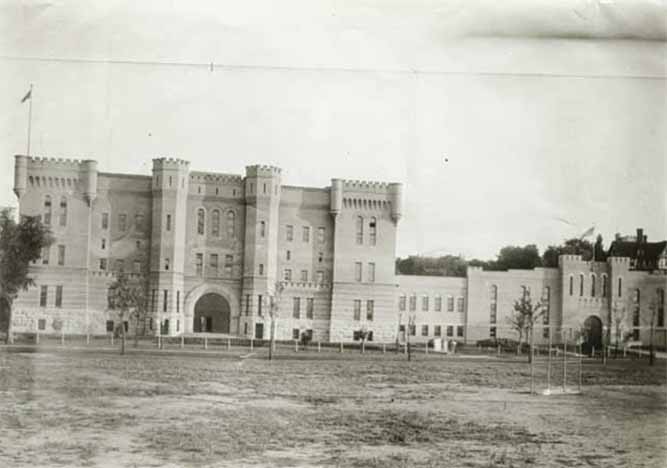
Kenwood Armory, 1908. Photo courtesy Minnesota Historical Society
One blog says that the building was built on sand, so the foundation kept sinking. The Kenwood Armory was demolished in 1934, and is now the site of the Walker Art Center Sculpture Garden.
THE MINNEAPOLIS ARMORY
The Minneapolis Armory is located at 500-530 So. 6th Street.
From the Historyapolis Facebook Page:
The Minneapolis Armory, a structure in downtown Minneapolis, is a relic from a forgotten age. This concrete fortress on the corner of 5th Street and 5th Avenue, on the eastern edge of downtown, is a monument to the city’s past troubles. Constructed in 1935, it was planted in downtown as a bulwark against revolution, a legacy of the civil unrest that happened on the streets of downtown Minneapolis in the summer of 1934. That year, battle lines were drawn between the Citizens’ Alliance – an employers’ organization – and a group of radical labor organizers, determined to win a greater voice for workers in a city known for its hostility to unions. Organizing first a union and then a strike, the Teamsters prevailed, but only after Governor Floyd Olson called in the National Guard to keep the peace. Troops under the command of Adjutant General Allard A. Walsh made the city into an armed encampment, setting up machine gun installations and military roadblocks around the downtown.
In the aftermath of the Truckers’ Strike, leaders of the National Guard decided to build their new military installation downtown, ignoring the protests of some city residents. There is “no reason why we should throw away more tax money in this smoky, semi-slum section of the city,” H.M Orfield argued in a letter to the editor, penned in 1934. “It will always be a rendezvous for transient laborers and homeless, hungry men seeking city aid.” The National Guard remained steadfast, arguing that events of the previous summer had demonstrated the importance of having a military installation at the center of the city.
Hoping that the construction would bring jobs and economic development to a deteriorating part of the city, community leaders embraced this effort, lending their support to the largest WPA project in Minnesota.
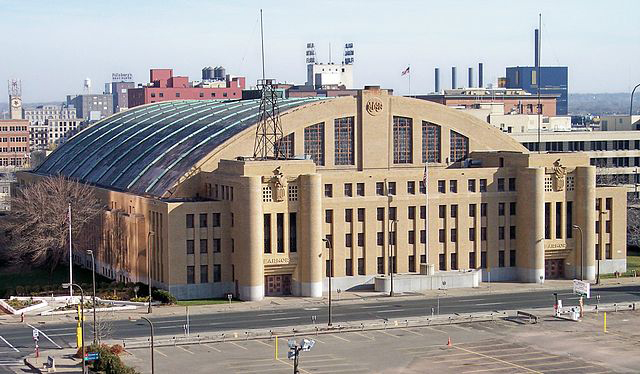
Musical performances were held in the building from the start, and lasted through the 1970s, hosting such luminaries as Jimi Hendrix, Janis Joplin, and James Brown.
Hennepin County bought the Armory in 1989 with plans to build a new county jail on the site.
The Minnesota Historical Society sued and in 1993 the Minnesota Supreme Court ruled that the structure was protected by state law and could not be torn down because of its historical status.
The building was put on the National Register of Historic Places on September 26, 1985.
Its next use was as a parking structure.
As of early 2017, the Minneapolis Armory was purchased by a new owner, revitalized, and now the host to a number of social functions: concerts, sporting events, trade shows, and other private celebrations.
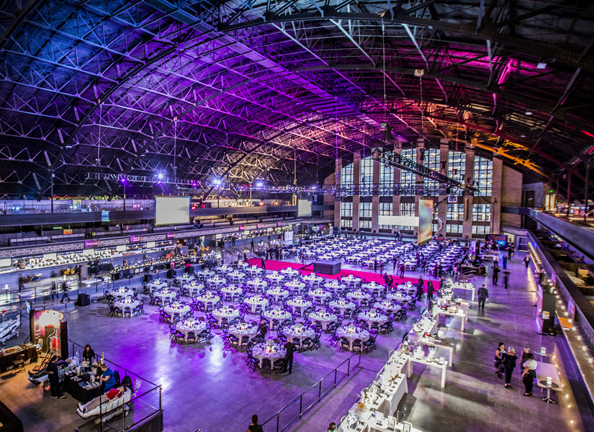
Star and Tribune, March 31, 2018
The Minneapolis Athletic Club was a place to hear dance bands.
The first iteration of the Minneapolis Auditorium was built in 1905 at 11th and Nicollet. That building became the Lyceum Theater.
The second (pictured below) was built in 1927 at 1301 Second Ave. So. [1403 Stevens] for $3.15 million. It had a 10,000 pipe tubular pneumatic action Kimball organ, said to be the fourth largest in the world, “the voice of Minneapolis.” It is now in storage in the convention center. The Auditorium opened on June 4, 1928. The Minneapolis Auditorium was home to the Minneapolis Lakers, the state’s first professional sports team, from 1947 to 1960. In August 1964, the space was renamed the Minneapolis Auditorium and Convention Center when a Convention Hall addition was built. In 1972, the auditorium manager began refusing to hold concerts by some hard-rock groups, such as Alice Cooper and Jefferson Airplane, after an incident at the St. Paul Civic Center where windows were smashed after a Black Sabbath concert. The auditorium was demolished in 1989.
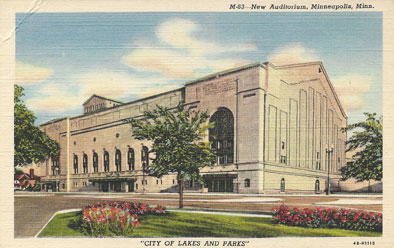
Minneapolis Auditorium
The Minneapolis Musicians’ Club was associated with the Minneapolis Musicians’ Union, Local 73 of the American Federation of Musicians.
Gene Bookman says it was active from 1916 to 1955.
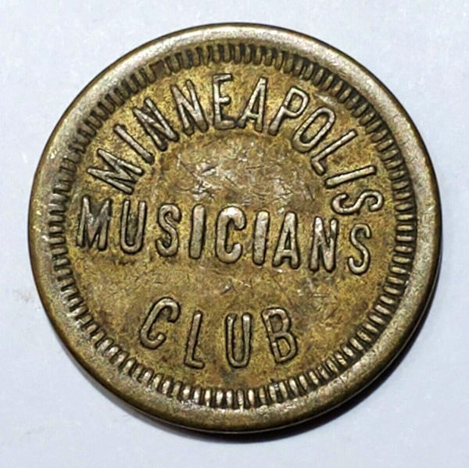
Token image courtesy Gene Bookman
In the late 1920s and early ’30s it was the scene of after hours jam sessions.
Please see Lyceum Theater
160 W. 9th Street, 1955
15th Ave., West Bank.
Here is a look at some of the acts who came to entertain us at the Minnesota State Fair through the years. This page is far from complete, and I’m finding some errors, but I’m updating this as fast as I can. Many thanks to Steve Grainger, former archivist of the Fair, who led me to the online Annual Reports. And thanks to Jon Burseth, who sent me the link to the August 1980 issue of Mpls. St. Paul Magazine, which had a huge collection of factoids about the Fair!
Thanks also to those who have sent in their snapshots from performances they have attended. If you have any photos or stories to share, please contact me!
HISTORY AND ENTERTAINMENT
The Minnesota Territory held three Territorial Fairs starting in 1854. Early fairs focused on agricultural exhibits and competitions, reflecting its original purpose of encouraging farming in the State.
The first Minnesota State Fair was held in 1859, the year after statehood. In its early years during the 19th century, the Fair was held in many different locations. The first was held near Downtown Minneapolis. Some were not far from the current site, but others were held in Greater Minnesota, including Rochester, Red Wing, Owatonna, and Winona.
The Fair was cancelled in 1861 and 1862 because of the Civil War and the Dakota War of 1862.
In 1865, New York newspaper editor Horace Greeley delivered an address on what Minnesotans could expect for the future. Among his predictions: that the state’s farmers would soon be able to control rainfall by firing heavy artillery into the upper air currents.
For a time in the 1870s, Minneapolis and St. Paul held competing fairs.
In 1884 a committee was put together by the Minnesota State Agricultural Society, the Fair’s governing body, to select a permanent site. The committee chose the Ramsey County Poor Farm, which was about halfway between Minneapolis and St. Paul. Ramsey County deeded the 200-acre site, worth an estimated $150,000 at the time, over to fair officials free of charge.
The first State Fair at its present location opened on September 7, 1885. The site was then 210 acres but is now 322 acres.
Entertainment has always played a big role – particularly the races held in the Grandstand. The original Grandstand was built in 1885, and the current Grandstand was built in 1909. Major improvements were made in the late 1930s and in 2002.
In 1898, one of the lowest attendances of any Minnesota State Fair was attributable to an outbreak of typhoid fever in July among a regiment of soldiers just back from the Spanish-American War. They were being quartered on the fairgrounds.
In the early days, musical Grandstand entertainment consisted of spectacular acts with casts of thousands. Gradually formulas changed as Fair administrators took note of changing tastes of audiences.
The following are some highlights of early years of State Fair music – random at first, then every year starting in 1957, when Ricky Nelson (and Brenda Lee) blew the roof off the Grandstand on Children’s Day.
1866
In 1866, the fair, held in Rochester, was generally conceded to be a bore. The only excitement occurred when a steed named Sleepy David dropped dead in the middle of a race.
1888
A unique attraction of the 1888 fair was a parade of 1,200 traveling salesmen.
1893
Scheduling issues between the Fair and the World’s Columbian Exposition in Chicago caused the 1893 Minnesota State Fair to be canceled.
1895
The fair showstopper of 1895 was the famous St. Cloud Bicycle Band. Band members played march music while pedaling around a dirt track.
1897
In 1897, it was widely advertised that a dog would parachute from a balloon and land right in front of the fair’s grandstand. Hearing of the event, the local humane society threatened fair officials with jail terms if any animals were mistreated during the fair. So it was a toy dog that floated down from the heavens and into the fairgrounds.
1899
In 1899, a grand pageant and fireworks display reenacting the American Navy’s attack on Manila during the Spanish-American War was staged. It was such a smashing success that subsequent fairs featured “The Burning of Moscow,” “The Destruction of St. Pierre,” “The Last Days of Pompeii,” “The Fall of Pekin(g),” “The Siege of Jericho” and “Rome Under Nero.”
1906
In 1906, Dan Patch, a harness race horse owned by M.W. Savage of Minneapolis, set a world’s record for a mile in front of a cheering crowd of 93,000. The record stayed on the books for over 30 years.
1908
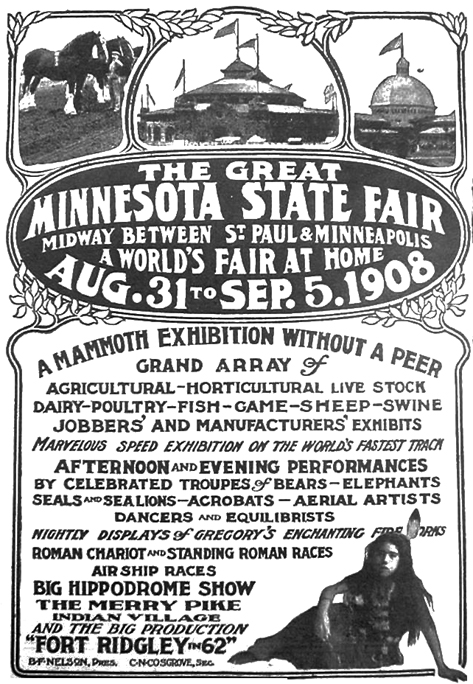
1912
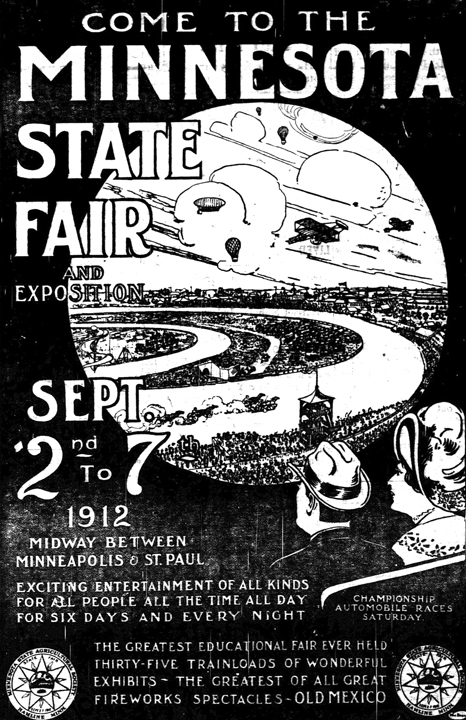
August 2, 1912 ad in the Dakota County Tribune
1920
In 1920, a big attraction on the Midway was a preserved corpse that was allegedly Abraham Lincoln’s assassin, John Wilkes Booth.
1923
The 1923 Minnesota State Fair and Northwest Dairy Exposition, September 1 to 8, 1923, had an entertainment program that was expected to be “easily the most stupendous bill of its kind ever contracted by any fair in America,” and would cost $150,000. Events included:
- 17 Spectacular Circus Acts
- Lillian Boyer in her Thrilling Change from a Speeding Automobile to an Airplane, Climaxed by Wing Walking and Parachute Drop
- Automobile Races, featuring Sig Haugdahl and his famous 3-mile-a-minute racing car
- 200 harness and running horses
- Auto Polo, America’s newest and most dangerous sport
- “Battle in the Clouds” each night by veteran aces Lieutenants Brock and Faulker
- Fireworks spectacle “India,” featuring elephants and a cast of 700.
- Dozen famous bands and orchestras
- Midway featuring 23 big attractions, recruited from all parts of the world.
- Scores of Educational Exhibits
- Mamouth Livestock and Poultry Show
- Eighty Acres of Farm Machinery
Northwest Bulletin, September 1923
1927
John Phillip Sousa and his 70-piece band played at the Minnesota State Fair from September 3 to 10, 1927. Sousa dedicated the new march “Minnesota” as the official march of the University of Minnesota. When the University president refused to meet him at the fairgrounds, Sousa presented the march to fair officials instead.
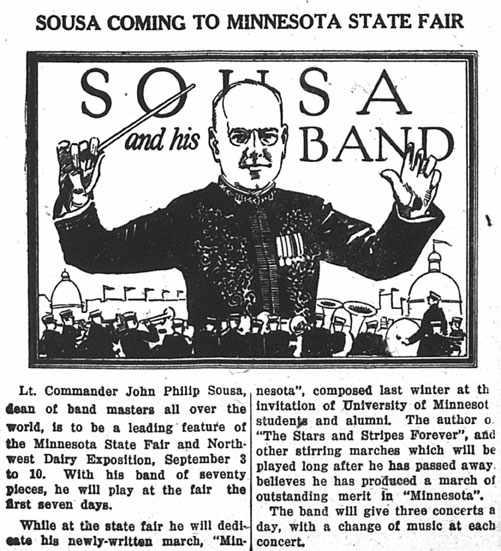
Ad from Minnetonka Record
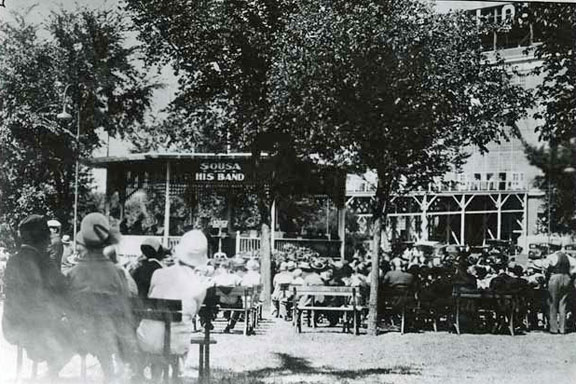
Photo courtesy Minnesota Historical Society
Another feature of the 1927 Fair was that children under age 12 were admitted free. The Midway shows were provided by Morris and Castle Shows, carrying 40 train cars of shows and riding devices. (Hennepin County Enterprise, August 18, 1927)
1930
The 1930 Minnesota State Fair and Northwest Livestock Show took place on August 30 to September 6. The ads for these huge events were usually quite compact with small lettering. Attractions included:
- Open air circus acts
- Auto and horse races
- Aviation thrill shows
- “Inspiring bands”
- A fireworks show called “The Awakening.”
- Ye Old Mill
- Carnival Rides
- Whoopee Way! – perhaps a precursor to the Midway?
- A 60-ton whale and other aquatic specimens
- A race between motor and beast in the lion’s den
- Boy Scout Indian Village, featuring real Indians
- Livestock show
- 60 acres of moving machinery
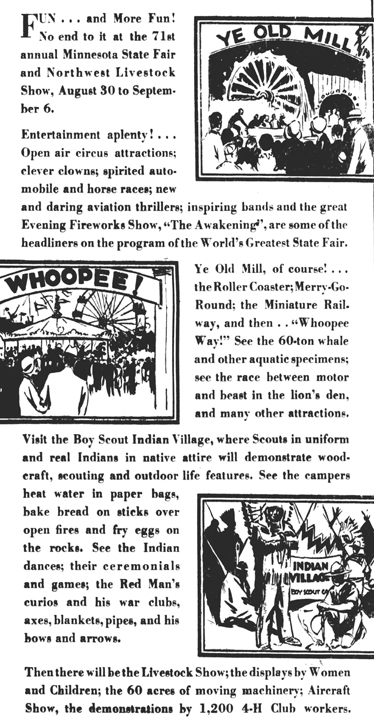
Minneapolis Tribune, Wednesday, August 27, 1930
1932
Although 1932 was the first fair to have four Ferris wheels in one spot, the event was a bust at the admission gate in this Depression year. Adding insult to injury, Phil Stong’s novel State Fair also appeared and credited Iowa with having the nation’s best state fair. These State Fair ads tend to be long and skinny and unreadable if I post them in their entirety. Below is the guts of a 1932 ad.

Minneapolis Tribune, Wednesday, September 7, 1932
1933
The climax of Thrill Day, September 8, was a collision between two locomotives, one marked “NRA” and the other “Old Man Depression,” before an overflowing grandstand crowd. On August 24, 1933, the Redwood Gazette described what would happen:
The leviathans of the rails will be in readiness at each end of the track and in full view of the thronged grandstand; the engineers will open the throttles wide, tie down the whistle cords and leap for life. The two thundering monsters will speed toward each other in a mass of steam and smoke – then the crash!!
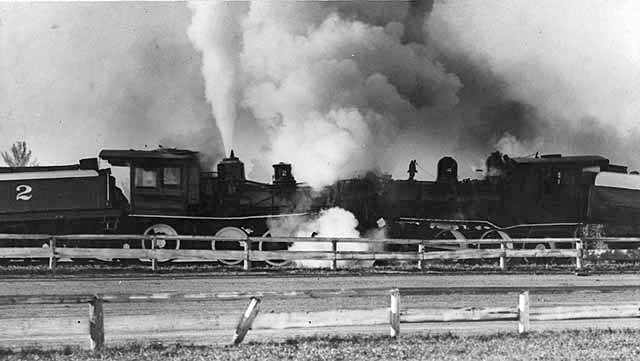
Photo courtesy Minnesota Historical Society
Footage of this remarkable crash can be found Here.
1935
The Night Show, called the State Fair Revue, made its premiere in 1935, according to this ad in the Hennepin County Review.
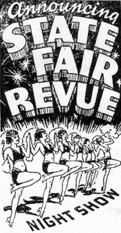
Top of the ad from the Hennepin County Review
SOARING TO NEW Heights of Grandeur . . . Tapping New Fields of Amusement . . . State Fair Revue, a Musical Extravaganza, will be Presented for the First Time to Grandstand Patrons.
NEW AND MODERN Scenic Designs . . . Revolving Stages . . . Gorgeous Costumes . . . Improved and Spectacular Lighting Effects . . . Dance Ensembles Direct from Radio City’s Music Hall . . . World-Famous Stars of Stage, Circus and Filmland . . . All Combine to Make State Fair Revue the Finest ever Produced.
FIVE FEATURE NUMBERS are Introduced in this Super Musical Creation . . . “Flying High” . . . “The Opera” . . . “The Circus” . . . “The Follies” and “Rise and Cheer.”
FESTIVAL OF LIGHT . . . A Smashing Fireworks Finale, Climaxes this Great State Fair Revue. . Every night. BEST SHOW IN HISTORY!
1936
Thousands looked on as the fair’s Thrill Day was capped by a dirigible balloon exploding above the infield. Less than a year later, thousands would look on in horror when the German dirigible, the Hinden-burg, exploded at Lakehurst, N.J., killing 36 people.
1938
The ad below for the 1938 Night Show is full of hyperbole; hopefully it is large enough to read. It comes from a publication aimed at visitors to Minneapolis.

Minneapolis Guide, September 10, 1938
1941
In these years, State Fair shows were usually spectacular productions with casts of thousands. 1941 was no exception, EXCEPT that on the first night, August 23, there was a special show starring Edgar Bergen and Charlie McCarthy, plus:
- Ted Weems and his “Beat the Band” Orchestra
- Buster West, film Comedian
- Paul Remos and His Toy Boys
- Lois Wolner and Her Singing Commanders
- and 12 Other Top Attractions
On the rest of the nights, August 24 – September 1, there was the World’s Greatest Outdoor Spectacular:
New! Dazzling! Different! Greatest Extravaganza of the Ages… A Musicomedy Studded with Stars from Broadway, Hollywood and Radio… Combining Beauty, Color, Comedy and Rhythm… 400 Living Artists… Five Stirring Episodes… 57 Stellar Acts.. 40 Chic Chorines.. A Fast-Moving, Hilarious Grandstand Production That’ll Made You Rock and Roar with Laughter… All Climaxed by Glorious Fireworks.
1942
Auto racing was suspended in 1942 because of gas rationing.
1943
In 1943, the Ramsey County Historical Society reports that the Hippodrome, some of the other livestock buildings, and 50 acres of land surrounding them were taken over by the government for an airplane propeller manufacturing plant run by the A.O. Smith Corp. Livestock, horse, and poultry shows were suspended.
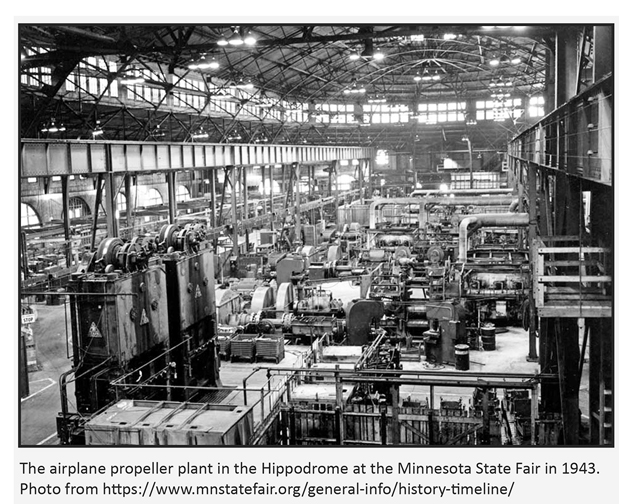
1945
The Fair again closed because of World War II because of a shortage of fuel and wartime travel restrictions.
1946
The Fair was again closed in 1946 because of an outbreak of polio. The Hippodrome had been so badly damaged by use for the airplane factory that it was demolished in 1946.
1947
A 1947 poll in the Minneapolis Tribune, which showed that only 7 percent of fairgoers named the Midway as their favorite attraction, sparked a crusade to banish the carnival from the fairgrounds. The fair’s bookkeepers had some figures of their own, however. For every dollar spent at the admission gate, 77 more cents were spent on the rides, sideshows and games of chance.
1948
Sally Rand, a dancer famous for her wardrobe of fans and bubbles, was the toast of the town during 1948’sfair week. Between shows and posing for newspaper photographs, she even found time to address the St. Paul Rotary Club. Her topic: “The Importance of 4-H Clubs.”
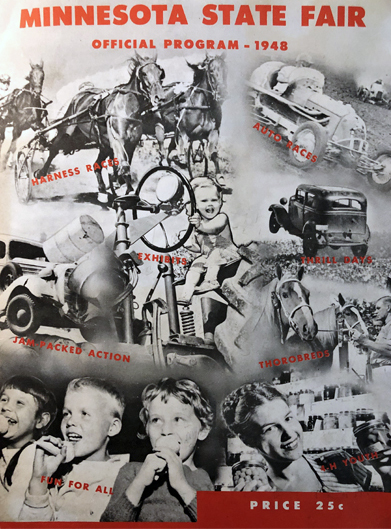
Image of 1948 Program courtesy David Black
1949
1949’s program only listed the evening’s entertainment quite casually as the State Fair revue.
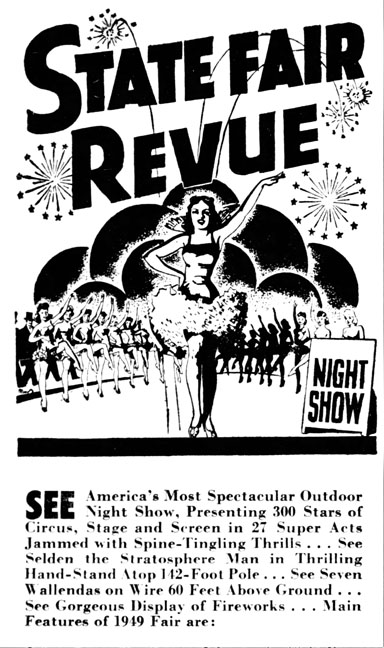
Minneapolis Star, August 26, 1949
But out on the Midway, the big entertainment was the tent of Gypsy Rose Lee!
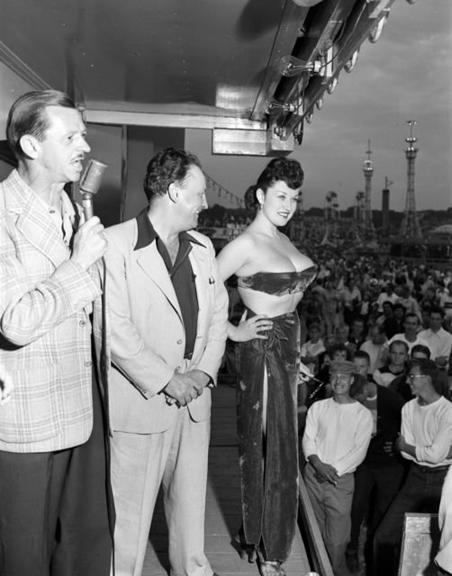
STOOGES!
But much ink was given to the arrival of the Three Stooges, who weren’t really appearing at the Fair, but at the Radio City Theater with Bing’s little brother Bob Crosby. It was billed as a “Giant State Fair Week Stage-Screen Show!” and their live show alternated between the showing of the movie “Africa Screams.”
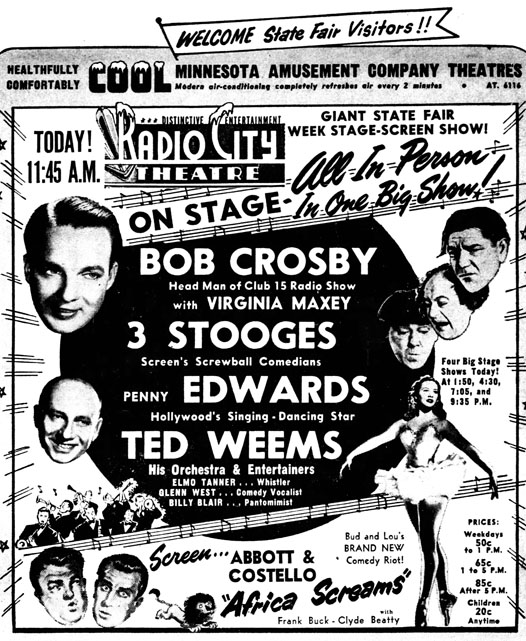
Minneapolis Star, August 26, 1949
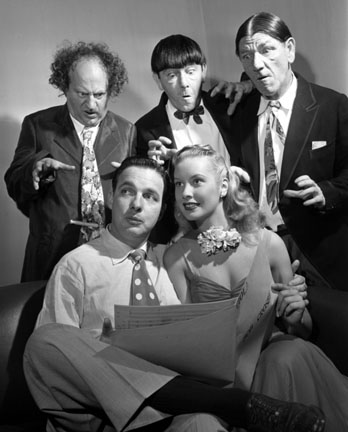
Minneapolis Star, August 26, 1949. Photo courtesy Minnesota Historical Society
1951
Stunt pilot Carl Ferris, with costar Kitty Middleton riding on his wing, failed to pull out of a steep dive and crashed, in full view of 18,000 people watching from the grandstand. Both were killed and it was the last aerial thrill show presented at the fair.
1955
A tradition of the fair had been Children’s Day, where kids ages 15 and younger were admitted to the Fair for free and treated to a special morning Grandstand show, either for free or for a nominal amount for tax. Up through 1954, the special Grandstand show consisted of circus and vaudeville acts.
But in 1955, there was at least a special feature, albeit not a musical act. It was Gene Autry and his horse Champion, sponsored by WCCO TV and Radio.
1957
It was pandemonium when Ricky Nelson, just 17 himself, appeared at the 1957 Children’s Day show on August 26. He played to more than 30,000 fans (according to the Fair’s Annual Report) from a stage erected “a zip code away in the center of an enormous racetrack”(according to Ricky’s biographer Philip Basche.)
Also appearing were the Four Preps, who dressed in silver lame jackets in order to be seen. But all eyes were on Nelson, who wore a cream colored jacket, white and burgundy polka dot shirt, and a white tie. With a limited repertoire, he also sang numbers by Elvis and the Everly Brothers.
Also performing at the 10 am show was Brenda Lee, who was just in Sixth Grade. While in town the two “TV and juke box stars” appeared on the local TV show “Treasure Chest.”
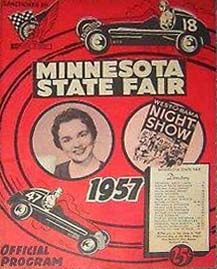
1958
Tommy Sands was the teen idol chosen to play at Children’s Day on Monday, August 25, 1958. Although temperatures were in the 40s, the Fair’s Annual Report estimated that 35,000 kids came by the busload to see the show that morning. Fair officials provided 30 mounted patrolmen between the Grandstand and the stage to prevent the star from being mobbed like Ricky Nelson did the previous year. Tommy, almost 21, was backed by a group called the Raiders. Appearing with Tommy was Gabby Hayes. The regular show was called “Star Spangled Spectacular.”
At about 2 pm the rains came, and the evening Grandstand show was cancelled. The Annual Report says that Tommy’s evening show was transferred to the Horse Show.
Also in 1958, it was clear that attendance would hit seven digits for the first time in history and a special reception was planned for the millionth visitor. As the turnstiles kept clanging, fair officials grew worried that Number One Million would be a married person out on the town with someone other than his or her spouse. Everything was on the up-and-up with Robert Karklin of St. Paul, however, and he seemed rather excited to get a new wristwatch along with free admission to the fair.
1959
Children’s Day was August 31, 1959, and featured some safe Western stars. Standing room only crowds saw:
- Johnny Horton
- Gabby Hayes
- The Chipmunks
- Rosemary Bailey (10-year-old concert organist – or was she 13?)
- Claude Gordon’s Orchestra
1960
The official program just described the night performance as an “All-Star show, Stage and Circus Acts, Fireworks.” The following ad, in slightly different iterations but with no more details, appeared throughout the Fair. Somehow the performers were really famous but their names didn’t merit mentioning!
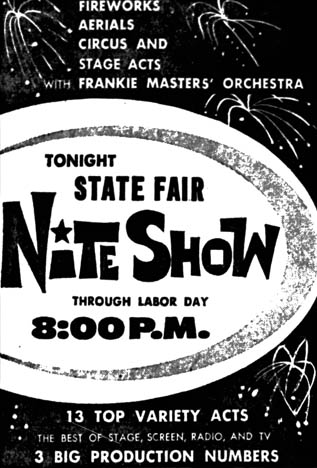
Minneapolis Star, August 27, 1960
CHILDREN’S DAY
It’s only thanks to the newspaper columnists that we find out who performed on Children’s Day, the only day that popular music was performed in the early days. Otherwise the acts were woefully poorly advertised in the newspapers.
1960 had two Children’s Days, with kids 15 and under getting in free. Shows were at 10:00 am.
On August 29, the acts were:
- 15-year-old Brenda Lee
- David Nelson. David was Ricky Nelson’s 23-year-old brother, and performed as a “catcher” in a trapeze act. He worked 32 feet above the ground with a net, catching his three co-workers, Del and Babs Graham and Walter Long. The Grahams taught him the techniques for a movie, “The Big Circus.” One of the columnists informs us that he did his act wearing baby blue, rhinestone-trimmed tights.
- Johnny Cash
- Gordon Terry (in a red jacket)
- Johnny Western (in a tartan jacket)
- Clowns, circus, and vaudeville acts
- Ann Marston, Archery champion
- The Browns (“an on-key singing group” per Barbara Flanagan)
- Fireworks
- Frankie Masters and His Orchestra
On September 2, the show featured:
- Anita Bryant
- Neil Sedaka
- Paul Evans
- David Nelson
- Gordon Scott (the current Tarzan)
- Clowns, circus, and vaudeville acts
- Ann Marston, Archery champion
- Fireworks
BREAKING UP THE CLUB LIDO
And this happened on Saturday night, August 27, at about 11:00: about 60 young men between the ages of 16 and 20, broke up some displays on the way to the Midway, with the intent of “breaking up” the Club Lido girlie show. The Fair’s police force prevented the youngsters from reaching the Midway, and the “young toughs” failed to follow up on their threat to come back on Sunday. Why they wanted to bust up a girlie show was not explained. (Minneapolis Tribune, August 29, 1960)
1961
The official Grandstand ads were again very bereft of detail, and the one below basically ran the entire run of the Fair.
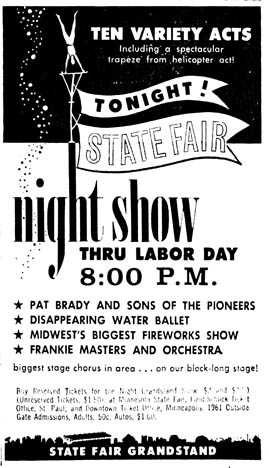
Minneapolis Star, August 20, 1961
In 1961, a longtime fair favorite, Leon Claxton’s Havana Revue featuring “scads of sultry sepia sirens,” showed up with a new name-the Harlem Revue. No explanation was given.
CHILDREN’S DAYS
There were two Children’s Days in 1961, where kids 15 and younger got in free to special 10:00 am shows.
The first was on Monday, August 28, 1961, a scorcher. 22,000 kids saw:
- Ricky Nelson, now 21, made a return performance in a maroon suit, Barbara Flanagan reported. Police were ready for mooning girls with mounted troops on the grandstand racetrack.
- Tony Bellus, reportedly another teen idol, who played guitar and accordion.
- Rocky and Bullwinkle
- Pallenberg’s Bears
- Harmon Killebrew also made an appearance, tossing a few baseballs into the crowd and holding a batting demonstration. Here he is in a white shirt and skinny tie!
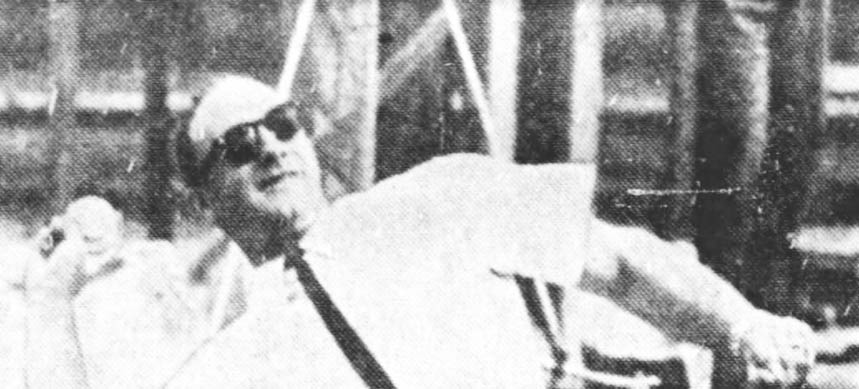
Minneapolis Tribune, September 2, 1961
September 1, 1961, was the second Children’s Day, with:
- The Four Preps
- Dodie Stevens
- Huckleberry Hound and Yogi Bear
- Tony Bellus
- Harmon Killebrew
- Pallenberg’s Bears
FREAK SHOW NEWS
Dick Best, the manager of the freak show, was interviewed by the Minneapolis Star. Best called the Minnesota State Fair the “Christmas” for all freak shows, where he could gross $40,000 over the ten days. He opined that show business was the therapy that gives the “Freak” a full life. The article described some of the freaks, including Betty Lou Williams, who had one head, two bodies, three arms, and four legs. With her earnings he was able to put her 11 siblings through college and buy her father a 260-acre farm. Betty Lou stayed with Best and his wife until her death at the age of 21. (August 28, 1961).
1962
GRANDSTAND SHOWS
The year 1962 ushered in the modern Grandstand show model, with a rotating cast of celebrities. Headliners were:
- August 25-27: Dennis Day – “brilliant comedy and musical show”
- August 28-30: “Glamorous Jane Russell in a dazzling performance”
- August 31 – September 3: Jimmie Dean

Minneapolis Star, August 24, 1962
Each night also featured the Warren Covington Orchestra, chorus, variety acts, and thrill shows.
On the Midway in 1962 could be found a baseball-playing chicken, a kissing rabbit, a drumming duck and a second chicken that danced the twist. Everybody was doing the Twist in 1962.
CHILDREN’S DAYS
Two Children’s Days were held in 1962. Performers on August 27 were:
- Bobby Vinton
- Joe Dowell
- Diane Emond – a 14-year-old from Minneapolis
- Leroy Van Dyke
- Clowns Emmet Kelly, Jr. and Carl Marx
- Mark Wilson, TV’s “Allakazam”
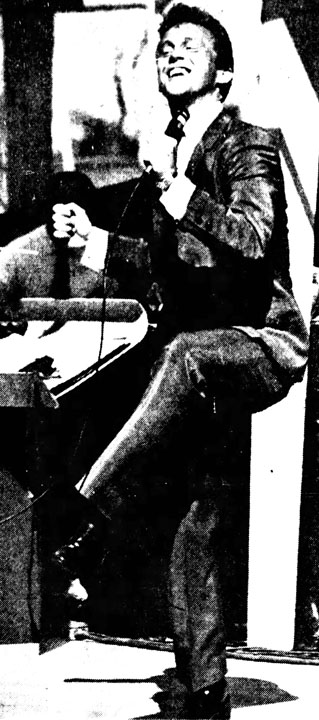
Bobby Vinton, twisting at his show on Children’s Day. Minneapolis Star, August 28, 1962
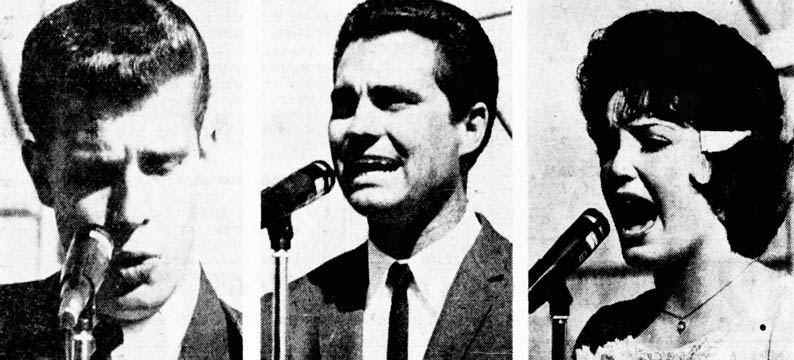
Joe Dowell, Leroy Van Dyke, and Diane Emond. Minneapolis Tribune, August 28, 1962
The second Children’s Day was on August 31, 1962. Performers were:
- Freddie Cannon
- JoAnn Campbell
- Diane Emond
- Acts from the night show
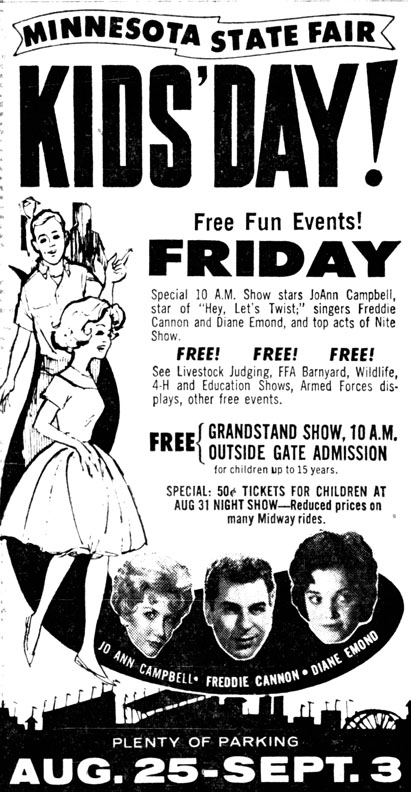
Minneapolis Star, August 28, 1962
1963
GRANDSTAND SHOWS
The Grandstand Show was called the North Star Spectacular. Headliners were:
August 24 – 28: Rosemary Clooney, Buster Keaton
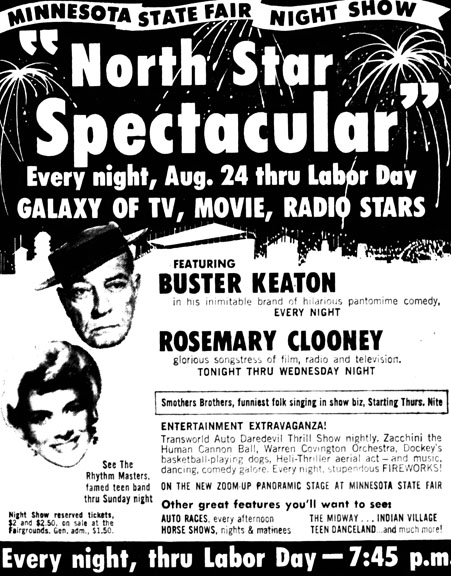
Minneapolis Tribune, August 26, 1963
August 29 – September 2: The Smothers Brothers, Buster Keaton
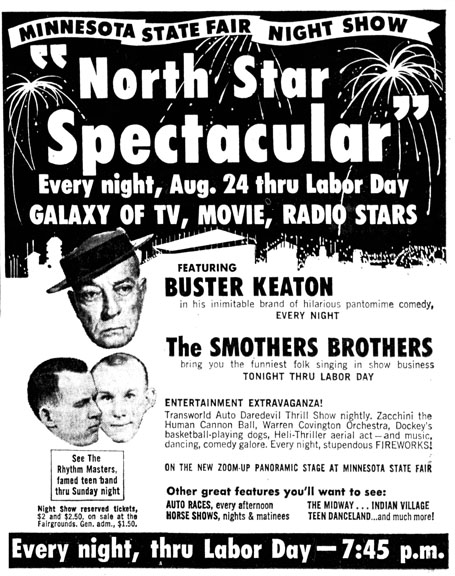
Minneapolis Tribune, September 1, 1963
Acts appearing all ten days in the Grandstand were:
- The Rhythm Masters. A lengthy article in the Tribune on September 1 explained that the Rhythm Masters was a group of seven teenagers who sang, tap danced, and played instruments, and actually lived with their managers, Mr. and Mr.s Emery Clay in Canoga Park, California. They were spending the summer on a tour of fairs, traveling in a bus.
- Zacchini, the Human Cannonball
- The Warren Covington Orchestra
- The Amandis
- The Appletons
- Nip Nelson
- Dockey’s Basketball-playing Dogs on the new zoom-up panoramic stage
- A helicopter aerial Act
CHILDREN’S DAYS
A change was made to Children’s Day in 1963: previously, kids 12 and younger got in the Fair gates free, and kids 15 and younger got into the special 10:00 am Grandstand show for free. Starting in 1963, the age limit for free gate entrance was raised to age 15.
The first Children’s Day was on August 26, 1963. Performers were:
- Paul & Paula
- Rooftop Singers
- Libby Horne
- Rhythm Masters.
- The Yeomen (from Edina)
- Zacchini, the Human Cannonball
- Carl Marx, the clown
- Libby Horne
Libby Who? She was the same age as Brenda Lee and made a record in 1957, but just didn’t click.
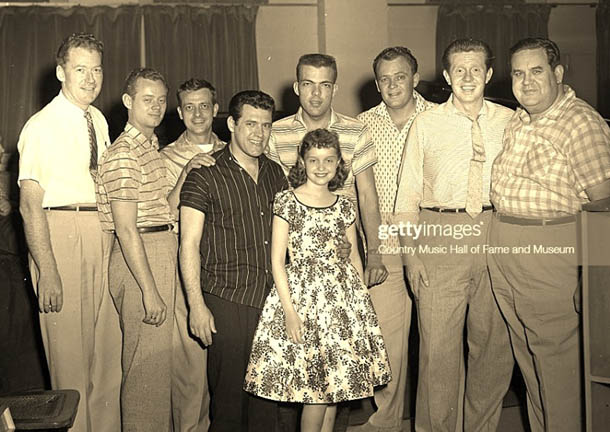
Wayne Glenn found this photo of Libby from 1957.
The second Children’s Day was held on August 30. Performers were the same except that instead of Paul and Paula, Bobby Vinton performed. James Darren was originally scheduled for the second show but was replaced by Vinton.
TEEN DANCELAND
1963 was the first year that teens had their own area at the Fair. It was described as in an Alpine setting across the street from the east end of the Grandstand. Dance sessions would be from 1:30 to 4:30 pm and between 7:30 to 10pm.
Will Jones said that the “Ballroom” opened with a “blast of electric guitar music” at 1:30 on August 24.
The customers crowded in – some to listen and others to jiggle around to the driving sounds of rock ‘n’ roll. Girls dance alone, together, or with any of the boys brave enough to get out onto the floor. (Minneapolis Tribune, August 25, 1963)
Barbara Flanagan also described it as Teen-age Danceland “ballroom,” and estimated one night’s attendance as 1,000 boys and girls, jiggling and jumping. Fair police chief George Cockriel said that in past years groups of teen boys had staged rowdy incidents after dark, particularly on the Midway, but such was not the case with Danceland in operation. In fact, Cockriel said, “We’re having more trouble with adults. I wish they could be as orderly as the teen-agers.” (Minneapolis Tribune, August 28, 1963)
KDWB may have been a sponsor of Teen Danceland. Performers included:
- The Starliners
- Rooftop Singers
- The Galaxies
- The Yeomen
- Rhythm Masters
- Libby Horne
- The Corvets
- Mike Waggoner and the Bops
An item in Bob Murphy’s column in the Minneapolis Star dated September 28, 1963, said that Morrie Steinman, a movie press agent from St. Paul, operated the 1963 Teen Danceland. Steinman died in 1976, and in addition to his work as a public relations consultant an theatrical promoter with Monogram Pictures, his work with Teen Danceland was noted.
Don Morrison noted in his column that Teen Danceland was one of the most successful new features of the 1963 State Fair. (Minneapolis Star, September 2, 1963)
Of course, the nature of the dancing I saw would seem to preclude opportunities for trouble. It is characterized by a vast physical and spiritual remoteness on the part of the participants. Dance partners establish a 6-to-8-foot cordon sanitaire between each other and go about their business in complete isolation.
Will Jones took his own swipe at the phenomenon in his column on September 2, 1963:
The crowds that jammed the fairgrounds yesterday added 10 degrees to the temperature of Teen Danceland, where hot hands wheedled warm whacks from electric guitars.
By 8:30 pm, 2,500 persons had been in the 95-by-60-foot room that makes up Teen Danceland. It was so crowded that the youngsters were twisting in the washrooms – and there was a line of youngsters a block long waiting to get inside.
From the 1963 MSF Annual Report:
Commonwealth Avenue echoed to a new sound this year – the beat of rock n’ roll music as young dance enthusiasts from the Twin Cities and across the upper midwest flocked to “Teen Danceland.” Initiated this year, Teen Danceland hosted more than 20,000 teen-agers who in turn were entertained by local rock n’ roll bands and guest celebrities. Teen Danceland’s proven acceptance has encouraged your Board to initiate expansion into a complete “Teen Age Fair” which will include teen exhibits, entertainment, fashion shows, talent contests, etc. for the 1964 Fair.
The last word goes to Willie Murphy, who was interviewed by Jim Walsh for a piece called Midway Memories, minnpost.com, August 24, 2017.
I remember playing out on the Midway, it must have been ’63, with some band I didn’t know but they needed a bass player. We played several days, eight yours a day, one set. The main song we played over and over again was, “Stick Out Your Can, Here Comes the Garbage Man.” I remember I signed a lot of autographs. Thesse kids from the country thought we were hot – that’s pretty funny. Then I remember the “Harlem in Havana” show – all black people, with a band and singers and dancers and they did Top 40 R&B hits, and that was great. The band was really good, and as a budding musician,I was really interested in that.
1964
GRANDSTAND SHOWS
- August 29 – September 2: The New Christy Minstrels and Anita Bryant
- September 3 – 6: Al Hirt and John Gary
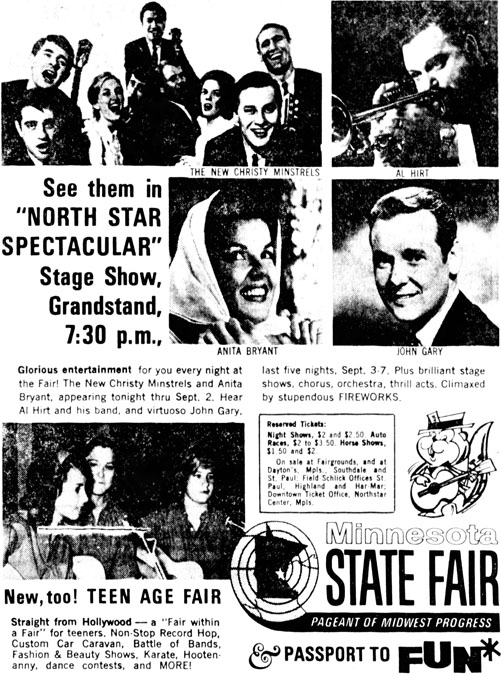
Minneapolis Tribune, September 1, 1964
Also on the Grandstand “North Star Spectacular” were:
- The State Fair Orchestra, directed by Jack Gillespie
- The Manhattan Rockets precision dance group
- Nip Nelson, Master of Ceremonies
- The Twin Eagles Sky Divers
- The Four Step Brothers dance team
- Don Rice, humorist
- The Half Brothers novelty act
- Roy Clark, singer-comedian (THE Roy Clark??)
- The Bumpy Spectaculars, tumblers
- Gus Augspurg and his Jungle Wonders
- The Sky Cycle High Act
The final Grandstand show on September 7 was cancelled because of rain.
1964 CHILDREN’S DAYS
Two Children’s Days were held in 1964:
On August 31 the entertainment was provided by:
- Bobby Vee
- The Yeomen
- Gus Augspurg and his Jungle Wonders
- The Bumpy Spectaculars
- The Sky Cycle High Act
- Other special entertainment from the night show
At the second Children’s Day on September 4, 1964, the Osmond Brothers replaced Bobby Vee. The other acts were the same.
OTHER ENTERTAINMENT 1964
- The Yeomen and the Last Straws performed in the Hippodrome on August 29, 1964
- Gene Eyman’s Orchestra performed in the Home Activities building, also on August 29, 1964
TEEN-AGE FAIR 1964
Last year’s premiere of the Teen-Age Fair was so successful that it was expanded into its own space in 1964. On August 24, 1964, Will Jones at the Minneapolis Tribune wrote in his “After Last Night” column that last year’s space was being repurposed (a word that didn’t exist in 1964?),
The Danceland at the State Fair building that was Teen Fair last year is being turned into the Li’l Old New Orleans Concert Hall this year. Three Dixieland bands – headed by Doc Evans, Harry Blons and Bob Gruenenfelder – will alternate there.
Here’s the Annual Report’s… report:
Based on the success of the Fair’s Teen-Age Dance held in 1963, it was decided that additional facilities aimed at teenage interest should be provided in 1964. In keeping with this idea, a three-and-a-half acre area near the Midway was fenced off and completely devoted to the teen-agers. This area, called the “Teen-Age Fair” had daily events and exhibits such as the “battle of the bands,” hootenany, fashion shows, custom cars, Miss Teen Northwest beauty pageant, etc. The Teen-Age Fair attracted better than 100,000 admissions and proved to be one of the most popular as well as noisy places on the Fairgrounds. Admission to the Teen-Age Fair was 50c.
Because of its success, it is planned to continue this event again in 1965. It should be noted here that the deportment of the teen-ager, not only in the Teen-Age Fair but over the entire grounds, was of the very best and seems to prove that if activity is provided to keep the younger element occupied, disturbances are considerably lessened. It is also interesting to note that the Royal American Shows’ Midway, in spite of the Teen-Age Fair competition, again shattered its income record by grossing $493,120.03.
Activities included:
- Fashion shows
- Cosmetics lessons
- Dance contests
- Motorcycle displays
- A booth for shooting a quick round of pool
- Karate demonstration
- Per Eddie Eiss, “There was a tent that had a large electric car racing set up, as that was a fad at the time.”
- Also per Eddie: There was a booth that let people doing some kind of painting that involved spinning a wheel.”
Some notes from the 1964 Teen-Age Fair:
- Century Camera had a booth where kids could have their pictures taken with full-sized cutouts of the Beatles (Will Jones, August 22, 1964)
- 42 bands kept up a 133-hour rock ‘n’ roll marathon. Three bands played at any given time.
- 52 singing groups participated in a “long-winded Harmony Hootenany” (Will Jones, August 26, 1964)
- The first four hours it was open, more than 5,000 teenagers of varying ages had paid their 50 cents to get in.
- The Safari Bash consisted of paying 25 cents for the privilege of bashing an old used car three times with a sledge hammer.
The B Sharp Booth featured the self-described “Garage Band” the Count Downs, featuring Gary Narducci. Here they are, in their garage, with their B Sharp equipment:
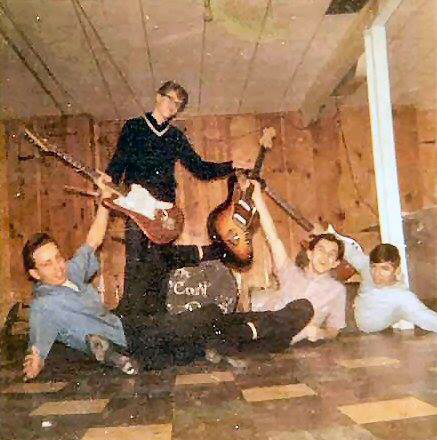
The Count Downs, courtesy Gary Narducci
THE MADRAS PLAID JUNGLE
Tribune writer Jerry Kirshenbaum reported on the “Madras plaid jungle” on September 3, 1964
Kirshenbaum listed the bands Johnny and the Hurricanes and the Underbeats as some of the professionals on hand. Hmm. The Underbeats were locals. He also gave advice on how to tell the pros from the novices, according to one St. Paul kid: “The pros wear lizard-skin pants.”
Another band, identified as a novice, was the Aristocats, who wore “powder blue cardigans, navy blue shirts and leopard-pattern ascots.” The band featured a 13-year-old drummer named Scott Sansby, who became one of the most prolific rock drummers in the Twin Cities. The article quoted his father, Jerry Sansby: “You think it’s loud out here. You outghtta be at our house when they practice.”
Kirshenbaum also commented on fashions: “Loafers are still in. Socks are out. Shades (sun glasses) are in. So is hair, very, very in. Combs are out. Shirttails are in – er, out. And so on.
He noted that there was a “gradual construction of a Mount Rushmore – style memorial to the Beatles. The memorial is being fashioned from sculptor’s clay. It will be a pink national monument, but nobody will say which nation gets it.”
FROM HOLLYWOOD
The production was somehow produced by a California-based company – Hal Sloane was the associate producer. It may have been some kind of franchised idea used at fairs across the country.
I’m not sure of the source of the following ballyhoo. Sorry for the bad reporting.
Straight from Hollywood – a 3-acre “Fair within a Fair” for teeners. Non-Stop Record Hop, Battle of Bands, Custom Car Caravan, Fashion and Beauty Shows, Karate demonstrations, Miss Teen Northwest competition, Hootenanny, dance contests, and MUCH more. Continuous program, all ten days and nights Adjoins the Midway, west of Grandstand. Admission (50 cents) covers all attractions. (Accompanied by cartoon of the State Fair Gopher playing a guitar)
BATTLE OF THE BANDS
The Battle of the Bands in 1964 had 40 groups. If your band was in it, please let me know! So far there were:
- The Casualties was the first band to play live, and started out with “Hello Josephine.” The Casualties eventually became the Sir Raleighs.
- The Lancers
- Michael’s Mystics
- The Trolls, with Eddie Eiss. Eddie says, “I forget just how many tents there were with stages for the bands. Not many. We played in one of them, not the big one.”
- Danny and the Night Sounds, featuring Danny Stevens. Danny’s group reportedly took first place in the contest, although I could not find a result in the paper. Later that year, Danny started a new band, this time calling it “Danny’s Reasons.”
FABIAN!!
The Miss Teen Northwest contest was held at the Teen-Age Fair. 19 entrants paraded in evening gowns, but the bathing suits were replaced by “white overblouses and black shorts.” 16-year-old Miss Bloomington, Patty Ann Cannon, won the competition.
Fabian, his own self, ‘coptered in on September 4, 1964, to present Patty Ann with a bouquet of roses, a gold loving cup, and a kiss. All Patty Ann could do was cry, but the crowd went wild as the teen idol brushed away her tears. He wore a dark brown suit and vest, white shirt, and a gold tie. (Minneapolis Tribune, September 5, 1964)
Fabian was on a publicity tour for his latest film, “Ride the Wild Surf,” and was immediately off to his next stop in Green Bay. Fan Diana LeMay had made him a large tiger-shaped cake, which he graciously accepted, but caused him to confer with staff as to how to transport in the helicopter! (Minneapolis Star, September 5, 1964)
Patty Ann was awarded a $750 wardrobe and an all-expense paid trip to Hollywood in the spring, where she was chosen third runner up in the Miss Teen-Age America contest. Patty taught Spanish and French at Kennedy High School and now lives in Florida. And she’s still beautiful! Thanks for the Facebook update, Patty!
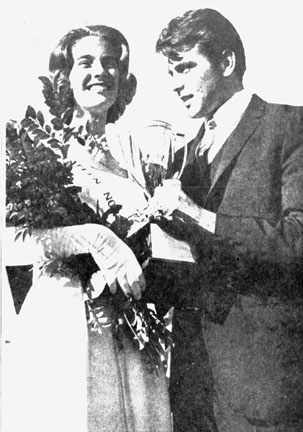
Fabian, presenting Patty Ann with her trophy. Minneapolis Tribune, September 5, 1964
1965
The North Star Spectacular Grandstand shows at the 1965 State Fair included the following. The snarky editorial comments are from an article in the Minneapolis Tribune by Allan Holbert dated August 30, 1965.
- August 28 – September 1: Mary Wells with Dixieland clarinetist Pete Fountain, who was a replacement for the originally-scheduled Al Hirt. Hirt asked to be released from the commitment when he was signed to a CBS-TV summer program “Fanfare” on Saturday nights. (Minnetonka Record, July 29, 1965). The August 29 show was cancelled due to rain.
Holbert: Fountain was a graduate of the Lawrence Welk school of music; knows what a big audience wants and gives it to them, namely melody. He doesn’t talk or joke or fool around, he just plays.
Holbert: Miss Wells does mostly ooh=ooh=aah blues songs at about the same tempo and no better and no worse than a lot of other blues and rhythm singers do. Included was “My Guy,” which was, she said, “No. 1 last year.” I completely forgot.
- September 2 – 6: Roger Miller and The Ray Charles Singers (not to be confused with the Raelettes). Their hit was the lovely “Love Me With All Your Heart.”
All shows:
- Master of Ceremonies Pete Pederson. Holbert: Tells some jokes, most of which are no funnier than they are tasteful.
- The Young Steps dance team. Holbert: Acrobatic and tap dances to really up-tempo big band tunes. Brother Bernie never stops smiling
- The Brook Sisters. Holbert: Three sisters who play fast and furiously on piano, drums, and organ. The little chubby one with the pigtails plays drums as easily as most kidis her age skip rope
- Don Rice, comedian. Holbert: His slow, dry Iowa-bred humor grows on you.
- Roger Ray, comedian: Holbert: His jokes are cornier than Rice’s but he got his share of laughs by clowning around with a marimba.
- Sharon Carnes, singer.
Holbert: Minnesota’s own Sharon Carnes looked just like a pretty local girl who’s gone off to make good in New York, which she has… There was occasional disagreement between the singer and Jack Gillespie’s Orchestra.
- The Nerveless Nocks, aerial act
- The Manhattan Rockets, precision chorus line
- The State Fair Orchesta, led by Jack Gillespie
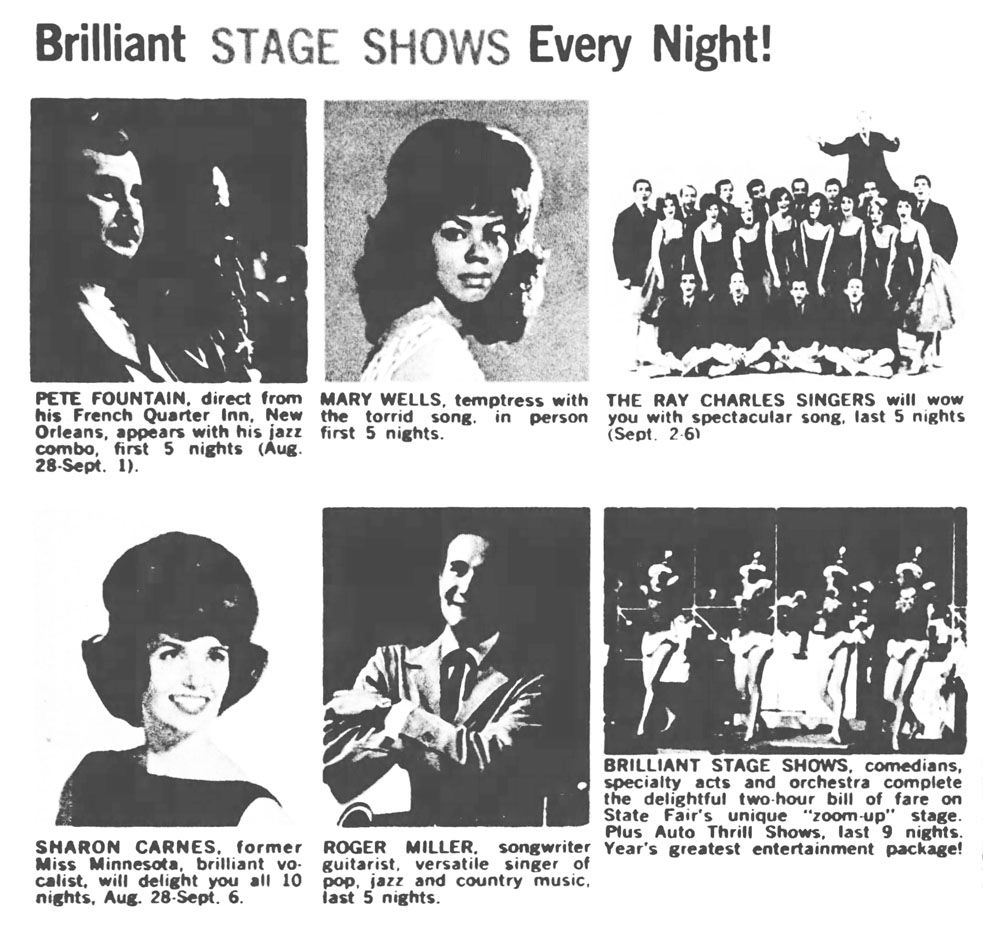
CHILDREN’S DAYS 1965
The first Children’s Day was August 30, 1965, although the free Grandstand show had to be cut short because of bad weather. Entertainment consisted of top acts from the night show.
- Mary Wells
- Young Steps
- Brook Sisters
- Yeomen
- Nerveless Nooks aerial act
The second Children’s Day was held on September 3. Appearing at the free Grandstand show were Roger Miller and the other acts listed above from the night show.
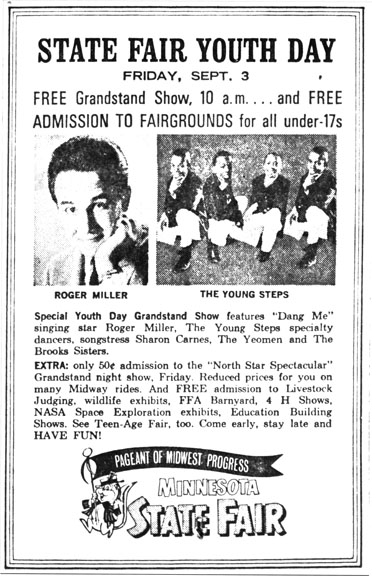
Minneapolis Star, September 2, 1965
TEEN-AGE FAIR 1965
A major improvement was the construction of a carousel-type dance pavilion approximately 100 ft. in diameter, which was used continuously through the dances and fashion shows. More permanent facilities were planned for 1966.
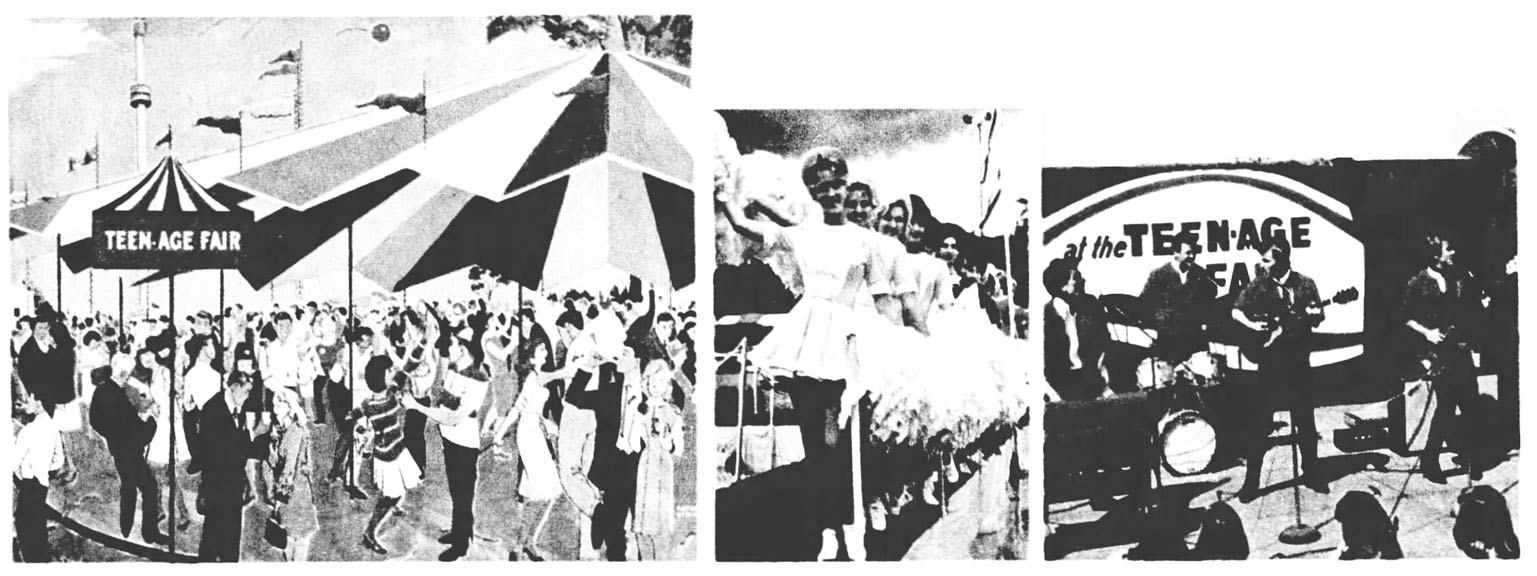
Minneapolis Tribune, August 15, 1965
The mascot of the Teen-Age Fair appears to be Fairchild in a Beatle wig.
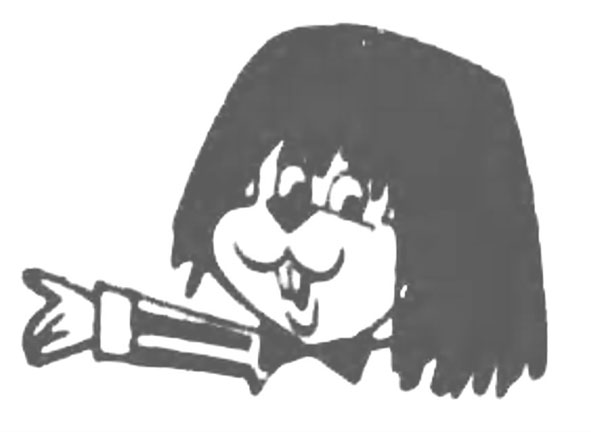
Minneapolis Tribune, September 3, 1965
Activities at the Teen-Age Fair included:
- A 50-group Battle of the Bands vying for a Hollywood contract
- Fashion and beauty shows
- Karate demonstrations
- Custom and classic car exhibits
- Hootenanys
- Miss Teen Midwest Contest
- Motorcycle and scooter shows
- Music store booths
TEEN BAND CONTEST 1965
At total of 67 bands competed in a nine day teenage band contest. The winner was Susie Q and the Originals, from St. Paul. Members were:
- Sue Drude, 17. Sue went on to have a successful singing career, and at one point was chosen as Miss Minnesota in the Miss Universe pageant.
- Darlene Vogel, 17
- Connie Bigelow, 16
- Rob McViegh
- Kelly Vincent, 15
Prizes included a recording session. Susie Q and the Originals also won an appearance on the Ted Mack Amateur Hour, which aired in the Twin Cities on Channel 4 on September 12, 1965, at 4:30 pm. Also on the show were Crowley’s Tumbleweeds, another St. Paul group.
Other top bands mentioned from the contest were:
- The Xpressmen, Harding High in St. Paul
- The Sir Raleighs, South Minneapolis
- The Bad Omens, Columbia Heights
There was a separate “harmony hootenanny” competition, won by Christoper Weber, 18, from Bloomington, who “bills his solo folk singing act as ‘Christian.'” (Minneapolis Tribune, September 6, 1965)
A search in the Strib for references to the Teen Fair in 1965 found these tidbits:
- A complaint from a 16-year-old that everyone there was smoking.
- A picture of a girl dancing in the “teen stockade.”
- An observation that Donaldson’s girdle booth was very popular.
- B-Sharp advertised for Go-Go girls to dance on stage with the guys. Me! Me!
- Canada Dry’s Wink pop was designated the official drink at the Teen-Age Fair.
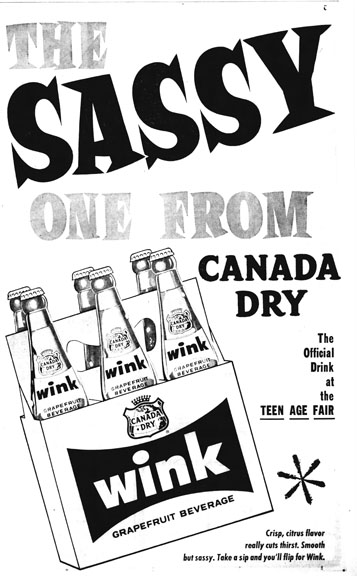
Minneapolis Star, August 26, 1965
WHO ASKED YA?
Allan Holbert, the Tribune’s future music critic, hated teens, I guess:
The loudest action, except for the auto races, was up at the Teen-Age Fair, where teen-age girls in funny clothes were watching teen-age boys in funny haircuts play loud and funny music on their electric music makers.
1966
GRANDSTAND SHOWS
The North Star Spectacular shows at the Grandstand shows were:
- August 26 – 30: The Supremes, with:
- Jerry Van Dyke
- Joie Chitwood’s Thrill Drivers
- Comedian Yonelly
- Ron Urban, magician,
- The Harmonica Hi-Hats
- Anden’s Poodles
- Aerielest Celeste
- Manhattan Rockets dance group
- Emcee Bob Potter of WCCO-TV
- State Fair Orchestra, directed by Eli Barnett
- August 31 – September 4: The Smothers Brothers with George Kirby
CHILDREN’S DAYS 1966
The first Children’s Day was staged on August 30, 1966, with a Grandstand show that was free for kids under 16. Featured performers were:
- Bobby Vee
- Chieftones
- Acts from the night Grandstand show.
The second Children’s Day was held on September 2, with the following performers:
- The Enemies
- The Chieftones
- Entertainment from the night Grandstand show.
YOUNG AMERICA CENTER 1966
The Teenage Fair was replaced with a permanent Young America Center, across Commonwealth Ave. from the Midway. The Young America Center was completely enclosed, with a permanent wall providing a backdrop for 61 cabana-style booths along two sides of the Center. An exhibit building was constructed on the eastern end to provide additional facilities for fashion shows, stage presentations, and similar attractions. Together with the existing carousel dance floor at the west end of the Center and a complete re-surfacing project, these additions created a considerably approved attraction. Attendance leaped past the 120,000 mark. (Annual Report, page 6). Bob Mecay was the Entertainment coordinator. The center featured permanent display booths, a circular dance pavilion and a fashion building, all built last year. Admission was 50 cents and approximately 100,000 teens came through in 1966.
There doesn’t seem to be a record of the schedule of bands that played at the Young America Center in 1966, unfortunately. I’ll make a list as I get more information.
- The Chieftones (billed as an “All-Indian band from Canada”)
- The Enemies
- The Fabulous Flippers
- The Exotics
- T.C. Atlantic (see below)
THROUGH A TEEN’S EYES, 1966
In an article for the July 22, 1981, issue of Sweet Potato, Daniel Gabriel reminisced about his first encounter with the Teen Fair. He remembered it as 1965, but it has been established that it was 1966.
When my circle of friends hit the Teen Fair for the first time we were astounded. There a full half-dozen makeshift stages scattered around the grounds, equipment piled on each. We spent the afternoon scrambling from stage to stage, digging one band after another. There was a pudgy fellow in a too tight suit who did a bad Eric Burdon imitation, an Indian band called The Chieftones, who wore headdresses and stamped their feet in time to Top 40 hits and – just for novelty – an all-girl band (The Exotics) decked out in knee-high boots and white lipstick. Their specialty was choreographed dance steps during the instrumental breaks.
. . .
As darkness descended, the headline act took the stage: TC Atlantic. While we bopped in abandon, they punched out a very danceable string of R&B tunes:
-
-
- It’s Gonna Work Out Fine
- Mona
- Stand By Me
- Spanish Harlem
-
They were tight, and with their stovepipe trousers and flowered ties they had the visuals down as well. TC Atlantic became my personal favorite – trendy mods, but with a flair for the classic.
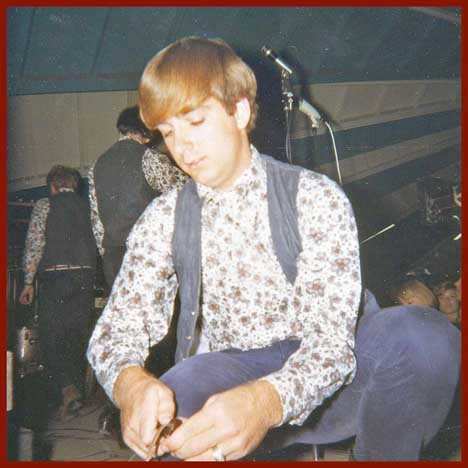
Bob Wells of T.C. Atlantic in his mod splendor – photo courtesy Vickie Hocking
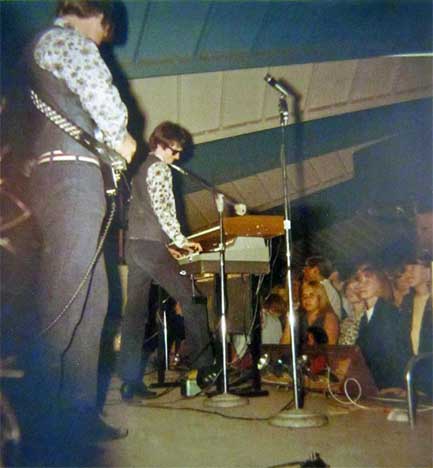
Bob Wells and Freddie Freeman – photos courtesy Vickie Hocking
THE BALLAD OF CHAD AND JEREMY
The English singing duo Chad and Jeremy were hired to play at the Young America Center for the first five days of the 1966 Fair.
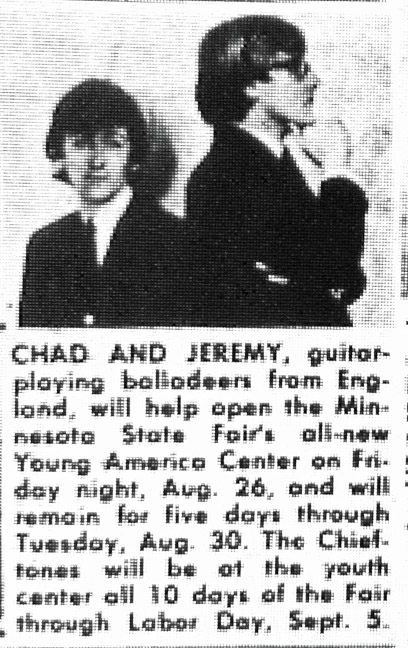
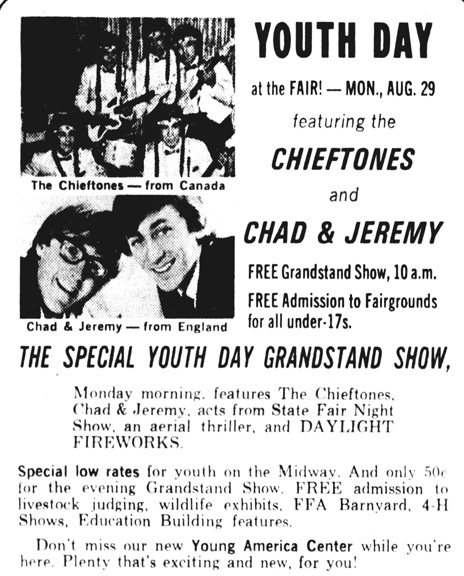
But a brou-ha-ha erupted when the pair walked out of the Fair after only two of their scheduled 15 performances on Saturday, August 27, 1966. The duo took their instruments back to the St. Paul Holiday Inn where they were staying after the two Saturday shows, and just didn’t show up for the Saturday night show. When a fair official called the hotel, he was told that they had checked out at about 6:00 pm. Bobby Vee, found on vacation in Detroit Lakes, stepped in to play the rest of their dates. The picture below was found in the negatives of WCCO-TV, leading us to believe it was a pretty big deal.
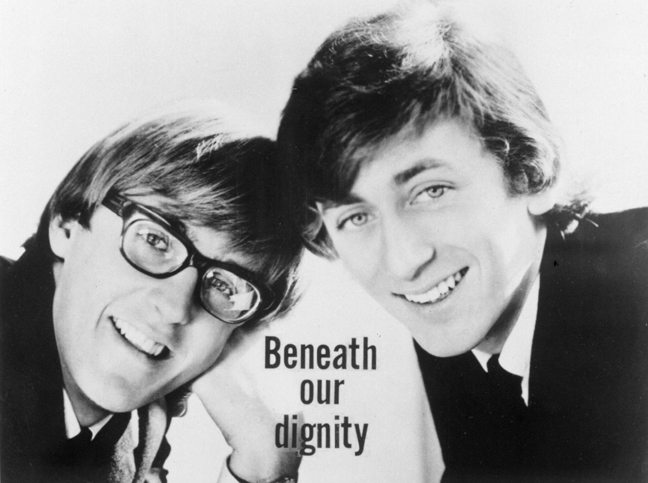
On August 31, 1966, the Minneapolis Star reprinted a story originating from Los Angeles that explained the misadventure. They said they had been told that they would appear on the Grandstand with the other big stars, but found themselves in a “teen pavilion” that consisted of a “hastily constructed wooden tent where people could freely wander in and out.” (The space was about 45 ft. in diameter which, with cramming, could accommodate 135 standing teenagers, reported In-Beat Magazine in October 1966.) They charged that teens did not have to pay to see them (which was not exactly true) and that they were exhibited “just like an awful side show, a sort of bearded lady-cum-dancing-bear act.” They acknowledged that their walkout was not professional but they were taking a stand against deceptive bookings.
The pair lost out on their $6,000 fee, a $6,000 breach of contract penalty, and potentially $7,500 in agents’ commissions.
Funny how the State Fair report that goes through the Fair day by day doesn’t mention this episode…
Now Jon Burseth writes of his experience at that show:
I was a bit surprised to see them in a venue where there was no admission charge and no seating. People, mostly teens presumably (I was still 19 at that time) were free to wander in, listen for bit, and then leave. Which is what we did. (I might’ve stayed longer, but my girlfriend, Jenni, was not really into that sort of pop music, so we listened & saw & moved on.) We were there long enough, though, to have the guys introduce their bass player; none other than J.W. Guercio! (Their drummer, on the other hand was a local guy, whose name did not ring any bells for me, so I didn’t take note. I wish I could find his name now.)
James William Guercio, if you don’t know, was all over the place in the ’60s and ’70s, working with the Buckinghams, Chicago, Blood, Sweat & Tears, the Beach Boys, Zappa, and… well, Wikipedia can tell you more. I’m sure he’s fabulously wealthy and he played bass for Chad and Jeremy, right here on our Teen Center Stage!
If you were the drummer, speak up!
1967
GRANDSTAND SHOWS
- August 25 – 29: The North Star Spectacular, featuring:
- The Baja Marimba Band
- George Kirby
- The Fuller Brothers
- Diane Shelton
- Berosinis
- The Berasek Chimps
- Ma-Ho-Pin aerial act
- West Harrison, comedian
- Manhattan Rockets
- State Fair Orchestra
- Bob Potter, WCCO-TV, emceed
- August 30 – September 3: Bob Newhart with the Young Americans (“Western Union”)
CHILDREN’S DAY 1967
The first Children’s Day was held on August 28, 2967, and kids under 16 were treated to a free morning Grandstand show featuring:
- The Flippers
- Candy Candido
- Gene Holter’s Wild Animals
The second Children’s Day was on September 1, and featured:
- The Kingsmen
- Candy Candito
- Gene Holter’s Wild Animals
YOUNG AMERICA CENTER 1967
The Young America Center at the State Fair was the place to be, with performances by:
- The Fabulous Flippers
- The Kingsmen
- The Sandpipers
- The Jade Set – an Oriental pop-variety group
- The Hot Half Dozen
- The Litter
1968
GRANDSTAND SHOWS
- Premiere Night, August 23: Coronation of Mrs. Ameria with comedians Allen and Rossi. Mrs. America was Mrs. Joan Fisher of Salt Lake City.
- August 24-27: The Fifth Dimension with Frank Sinatra, Jr. and Ballet America with its lightning-paced choreography of the early American West. Shows opened with Joie Chitwood Thrill Show.
- August 28: Country and Western Night. Stars from the “Opry” recreate their hits: Marty Robbins, Sonny James, Hank Williams, Jr., Connie Smith, and Lamar Morris. This was the Fair’s first foray into Country music, and drew a record-breaking 15,000 people to the Grandstand on August 28.
- August 29 to September 1: International Nights with Jack Jones and the National Ballet of Mexico. Rain almost cancelled the shown on the 31st, but iti was somewhat rearranged and staged as usual.
CHILDREN’S DAYS 1968
Children’s Day was held on August 26, 1968, and featured a free Grandstand show in the morning to those under 16. Performers included:
- The American Breed
- Ventriloquist Jimmy Nelson
The second Children’s show was at 9:30 am at the Grandstand on August 30, and featured:
- The Grassroots
- Jimmy Nelson
- Candy Candido
ADMINISTRATION PARK BANDSTAND 1968
- Up With People
INSIDE – YOUNG AMERICA 1968
- August 24-28: The American Breed, Mystics
- August 25-26: The Fabulous Flippers
- August 29 to September 1: The Grassroots
- August 30 to September 2: The First Edition (presumably with Kenny Rogers)
- “Plus fashions, exhibits, clinics, continuous music and pow. Open noon to 10:30.”
The following are snapshots of the Grassroots, taken by Luise Barton.
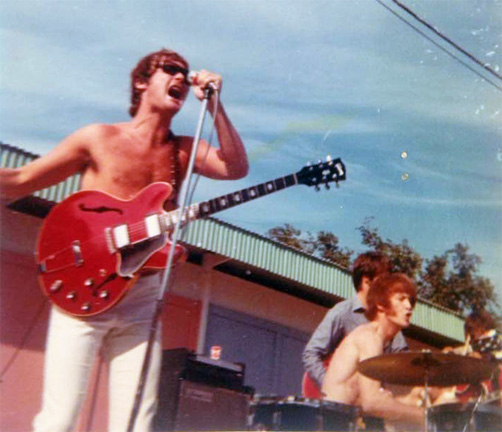
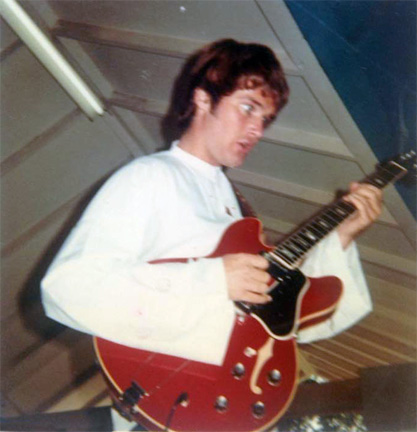

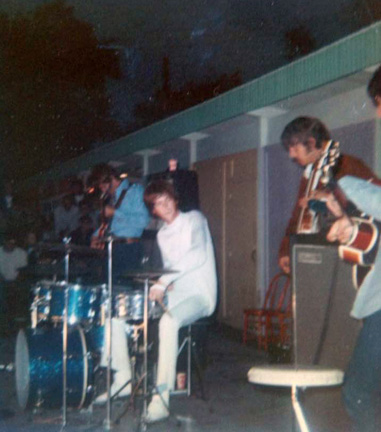
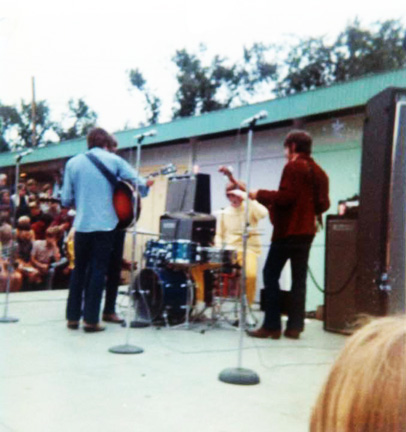
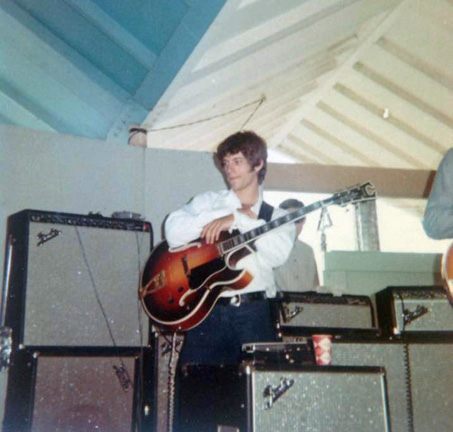
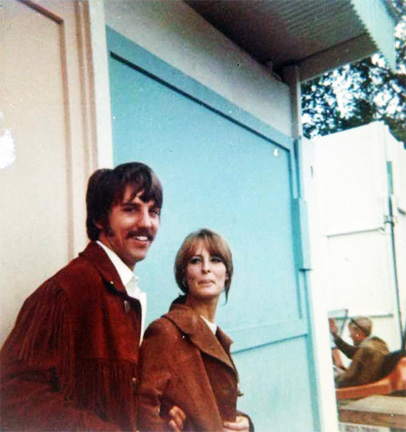
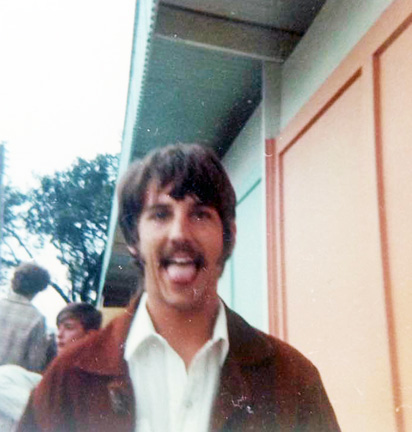
1969
GRANDSTAND SHOWS
1969’s Grandstand shows continued to be middle-of-the-road (or perhaps even off road):
- August 22: Buck Owens and the Buckaroos, Susan Raye, and June Carter Cash, the Carter Family, and the Statler Brothers. Billy Walker and the Tennessee Walkers
- August 23 -25: Lesley Gore, George Kirby, the Brothers and Sisters, Larry Griswold
- August 26: The Johnny Cash Show with the Statler Brothers, June Carter and the Carter Family, Carl Perkins and the Tennessee Three. For the first time in the history of the Grandstand show, the show sold out to an SRO crowd of over 24,000l The reserved and box seats for this show were sold out ten days beforehand, with 10,000 left for general admission. A Fair publicist said there hadn’t been a night like it since the Depression when a car was given away at every concert. During the afternoon the police were called to the Grandstand after a ticket booth was nearly destroyed by the surging crowd. Cash sang 19 songs and two encores, including:
-
- A Boy Named Sue
- Folsom Prison Blues
- Gray Stone Chapel Here at Folsom
- I Walk the Line
- Ring of Fire
- Daddy Sang Bass
- Johnny Yuma
-
- August 27, 1969: Porter Wagoner, Dolly Parton, Jerry Lee Lewis, Lynn Anderson, Speck Rhodes, and Conway Twitty
- August 28 – 30, 1969: Patti Page, Don Rice III with the Kids Next Door, Stebbings Dog Act, Duo Armedis Dance Team
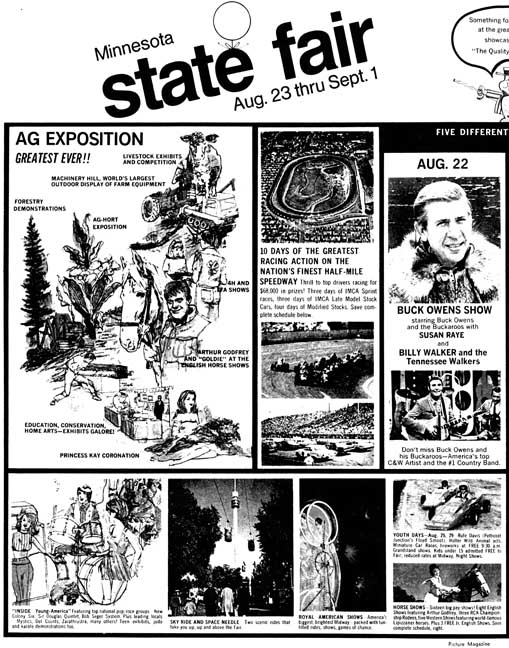
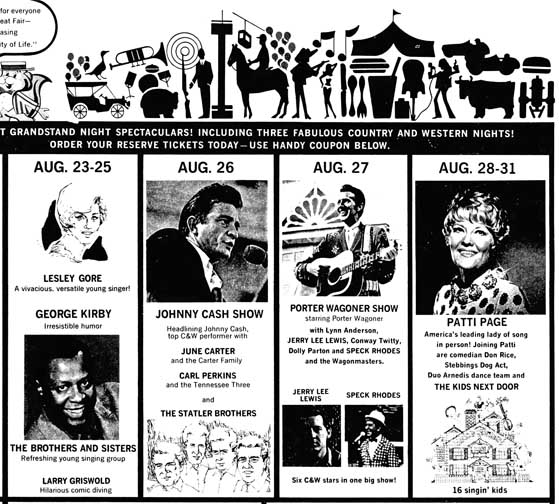
CHILDREN’S DAYS, 1969
The first Children’s Day was held on August 25, and the entertainers included:
- The Sir Douglas Quintet
- Rufe Davis from “Petticoat Junction”
- Candy Candido
- Holter Wild Animal Circus
The second Kid’s Day was held on August 29. Instead of Sir Doug, the New Colony Six performed.
1969 HORSE SHOW
Arthur Godfrey and his high-stepping Palamino, “Goldie” were featured during eight English horse show performances. The plaus three rodeos and five western horse shows drew 52,290 spectators.
GRANDSTAND PARK 1969
- Up with People
- The Fair Tyme Singers performed at the bandstand and six days at the night show.
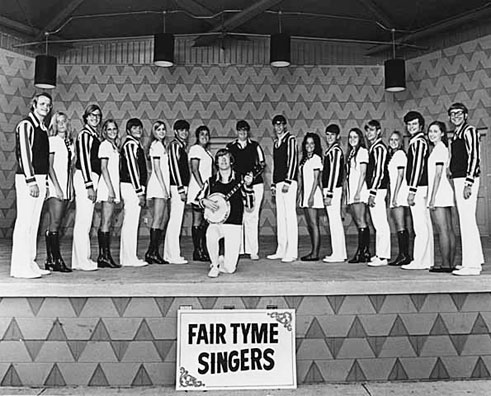
Minnesota Historical Society
INSIDE – YOUNG AMERICA 1969
The 1969 youth fair at the State Fair was called Inside Young America. National acts were:
- August 23-25, 1969: Sir Douglas Quintet
- August 26-29, 1969: The New Colony Six
- The Bob Seger System, August 30 – September 1, 1969
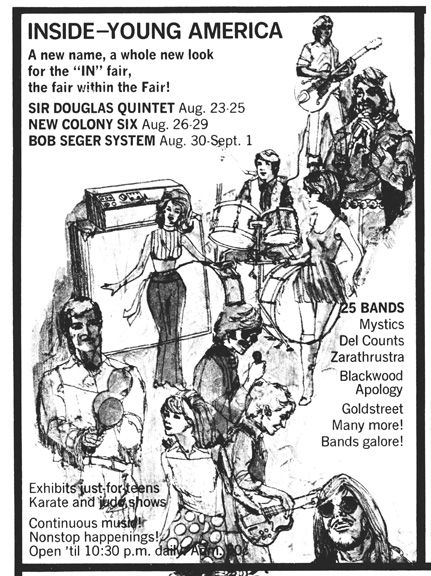
Local acts included:
- The 19th Amendment
- Mystics
- DelCounts
- Zarathustra
- Goldstreet
- Blackwood Apology
- C.A. Quintet: August 25, 30, and 31, 1969
100,000 kids paid 50 cents to see music, karate and judo demonstrations, fashion shows, etc.
1970
GRANDSTAND SHOWS
A new format was introduced for Grandstand shows in 1970. Instead of just one show per night, some of the performers did two shows. The highlight was when Johnny Cash drew 26,000 people for his two shows.
August 28: Sonny James, Jeannie C. Riley, Faron Young, Bobby Wright, and Jimmy Davis
August 29: Bobby Vinton, the Cowsills, and the Impact of Brass.
August 30: Bobby Vinton, the Cowsills, the Impact of Brass, Mlle. Louise and her Parisian Doves, Jack Durant and the Meener Trio.
August 31: Bobby Vinton, the Cowsills, the Impact of Brass, and the Fair Tyme Singers
September 1: The Johnny Cash Show with June Carter, the Carter Faamily, Carl Perkins, the Tennessee Three, and the Statler Brothers (2 shows)
September 2 and 3: The Lawrence Welk Show (2 shows)
September 4: Petula Clark, Art Linkletter, the Fair Tyme Singers, the Golddiggers (Dean Martin’s chorus girls), Gerard Soule with his dogs.
September 5: Petula Clark, Art Linkletter, and the Golddiggers
September 6: Charlie Pride, Johnny Duncan, the North Door Singers, and the Fair Tyme Singers
CHILDREN’S DAYS 1970
The first Children’s Day was on August 25 and the morning Grandstand show featured Candy Candido, the Trinidad Tripoli Steel Band, and Gene Holter’s circus animals.
The second Children’s Day was on September 4, and added the racing Sipolt brothers, the baton-twirling Lieb Sisters.
Fess Parker (TV’s Daniel Boone and Davy Crockett) was featured at the eight English and five western horse shows as well as the three rodeos in the Hippodrome. Parker appeared with the group The New Establishment.
ADMINISTRATION PARK BANDSHELL 1970
- Trinidad Tripoli Steel Band
- North Door Singers
- Betty Rydell Trio
- Barbara Mandrell
- Fair Tyme Singers
- Phillip Whitecloud Indian Dance Troupe
- Up With People
This bandshell was substantially improved and made permanent right after the 1970 fair.
YOUNG AMERICA’S MIND ODYSSEY 1970
The 1970 youth pavilion was called Mind Odyssey, and promised “no bubblegum.” Nova Lights put on the light show, as they did at the Labor Temple. Among the activities were performances by Shakespeare in the Street. The guys in Pepper Fog remember that it was very hot, not helped by the fact that the stage area was all painted black. Close to 100,000 young people came to the special area of the fair in 1970.
National headliners were:
- August 30 – September 2: James Gang (with Joe Walsh). Local group Pepper Fog opened for them two days in a row, says famed P-Fog keyboardist Gregg Inhofer. “We opened with “Funk 49,” a James Gang tune. Their manager told us to knock it off. We thought it was ok since they had just come out with “Funk 49.” Kids, can’t take em anywhere.”
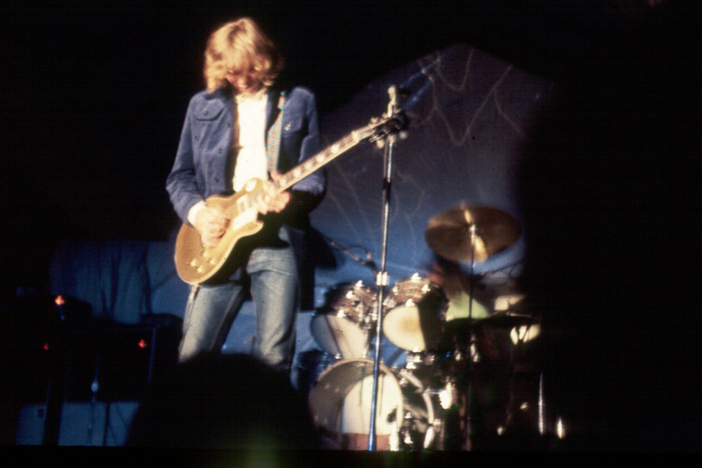
James Gang, 1970 Teen Fair. Photo courtesy Al Bjerke
- September 3 – 7: Sha-Na-Na
The Insider listed no less than 13 local bands for your dancing pleasure:
- Mystics (August 31, September 1 and 5)
- Marauders
- White Lightning (September 2)
- System (August 31)
- Big Island (September 5)
- Danny’s Reasons (September 2)
- CA Quintet (September 6)
- Sir Raleighs (August 30)
- Zarathustra
- Fenatiks (August 30)
- Pride and Joy
- Peace
- Sunshine World (September 1)
- Kiwani (September 2 and 6)
- Syndicate (September 5)
Dave Lowe also remembers that his band, Karisma, played at Mind Odyssey that year, and posted this photo to Facebook:
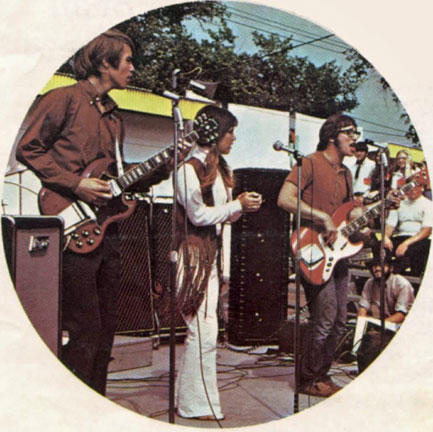
Dave Olson, Connie Olson, Dave Lowe
Copperhead also performed, as evidenced by the photo below:
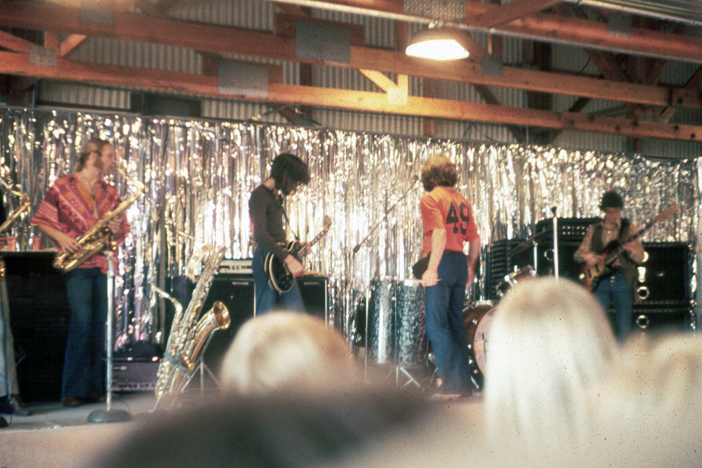
Photo of Copperhead, 1970, by Al Bjerke
1971
GRANDSTAND SHOWS
August 28, 1971: The Carpenters, John Davidson, Della Reese, and the Harmonicats (two shows)
August 29, 1971: The Carpenters, John Davidson, Della Reese, and the Harmonicats (one show)
August 30 and 31, 1971: Tony Sandler & Ralph Young, the Doodletown Pipers, Wes Harrison, and the Skeets Trio
September 1, 1971: Tammy Wynette, George Jones, Loretta Lynn, Jack Greene, Osborne Brothers, Roy Acuff, Jeannie Sealy and the Smokey Mountain Boys. This show drew over 11,000 spectators.
September 2 and 3, 1971: Liberace with Julie Budd and the King Kovaz Auto Thrill Show
September 4, 1971: Neil Diamond and Odetta (2 shows). More than 24,000 people attended these shows.
September 5, 1971: The Charley Pride Show, with Conway Twitty, the Betty Rydell Trio, Johnny Duncan, Alex Houston with Elmer, and the King Kovaz Auto Thrill Show (two shows).
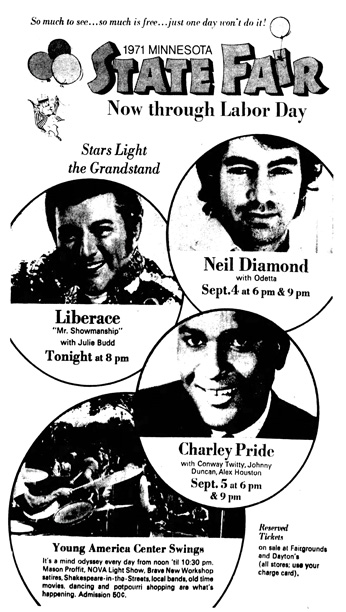
CHILDREN’S DAYS 1971
August 30 was the first Children’s Day, with a free 9:30 am show in the Grandstand for those under the age of 16. Performers were the Serendipity Singers, the St. Louis Park Parkettes, Candy Candido, and Gene Holter’s Wild Animals.
The second Kids’ Day was on September 3, with the same performers.
Festus (aka Ken Curtis) of the TV show Gunsmoke was the star of an English Horse Show in the Hippodrome on August 30 and 31 and September 1.
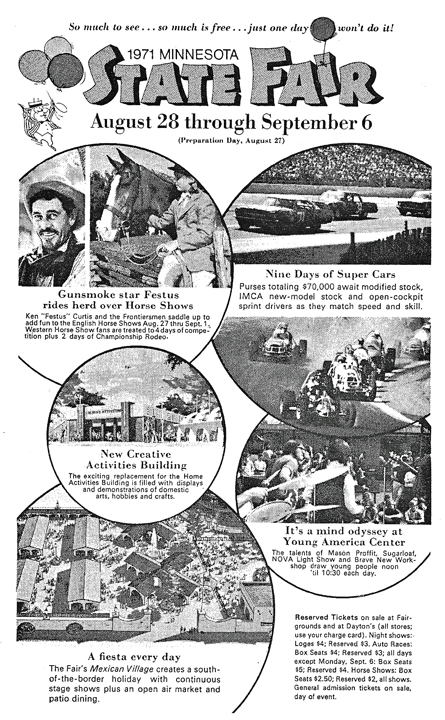
TV Guide ad, August 28, 1971. Courtesy Jeff Lonto
ADMINISTRATION BANDSHELL 1971
1971 saw the construction of the new bandshell that featured free entertainment. The first year presented:
- The Trinidad Tripoli Steel Band
- Betty Rydell Trio
- Sound Generation
- Serendipity Singers
- Fair Tyme Singers
YOUNG AMERICA MIND ODYSSEY 1971
“It’s a mind odyssey at Young America Center. The talents of Mason Proffit, Sugarloaf, NOVA Light Show and Brave New Workshop draw young people noon ’til 10:30 each day.”
National acts were:
- August 28 – September 1: Sugarloaf
- September 2 – 6: Mason Proffit
Richard Hanson shared this story about Sugarloaf on Facebook:
I spent an afternoon hanging out with this really cool guy. Watching groups, talking music and discussing musical icons.
The announcement came over the loudspeaker that Sugarloaf would be starting in 5 minutes in the pavilion furthest from the entrance.
We started making our way towards the area.
Got under the roof and he turns to me, says, well.. I gotta go. We shake hands and he walks towards the stage, up the stairs to the stage and picks up the bass guitar and starts making certain it was in tune.
All day talking and he never mentioned he was the bass player from Sugarloaf… The reason I was there that day.
I LOVE the long version of “Green-eyed Lady!”
Here’s another story:
Had some friends that were smoking pot under a tree at the top of a hill. All of the sudden a bunch of these guys on horse back start riding towards them. Hey. Cool. Here comes the rodeo and we’ve got a prime spot. They were a bunch of Sheriffs. Luckily they were underage.
His friend said:
I was there – Mason Proffit was playing. I thought it was funny because “Two Hangmen” was being played at the time.
Jack Murphy shared these photos of Mason Proffit on Facebook:
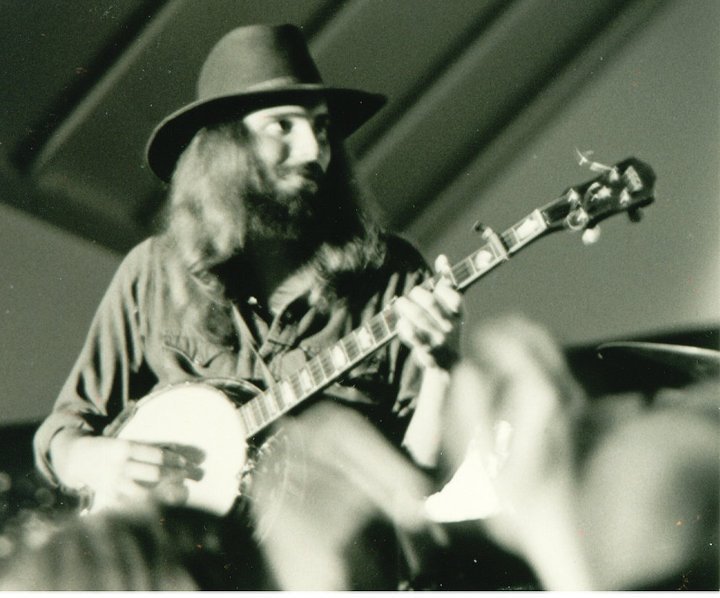
Photo courtesy Jack Murphy
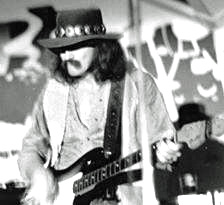
Courtesy Jack Murphy
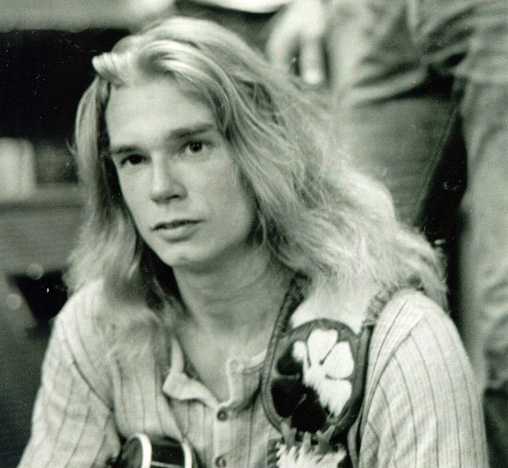
Photo courtesy Jack Murphy
The Insider listed 17 local bands that played at the 1971 Teen Age Fair. Wish I had written them down. If anyone has the list, please let me know! Somewhere it says that on August 30, the bands Light, the Paisleys, and Danny’s Reasons performed.
Mind Odyssey also featured Nova Lights, the Brave New Workshop, Shakespeare in the Streets, and Old Time Movies.
Paul Metsa shared this funny memory with Jim Walsh for his piece, “Midway Memories,” minnpost.com, August 24, 2017.
The State Fair was an annual trip my family took where we pick up Grandma and Grandpa Paul in Mora, Minnesota (Mom”s folks) and spent a day at the fair. In 1971, Grandpa and I were traipsing around the Midway and saw an exhibit that said something to the effect of “Experience an LSD Trip.” Game on. Grandpa and I entered what I remember to be a railroad car with a hippie gal taking tickets replete with Granny Glasses and a tie-dyed dress.
Once inside we were welcomed by “White Rabbit” by the Jefferson Airplane on 11 There was a headache-inducing strobe light, incense (no peppermints), and a display behind glass of what looked like two poorly rolled joints and a hypodermic needle. That is about all I remember and felt comfortable enough when we left to know Grandpa Paul was not inspired enough to buy a van, move to the coast, and follow the Grateful Dead.
1972
GRANDSTAND SHOWS
- Sonny and Cher with David Brenner: August 26 – 27 (three shows over two nights)
- John Denver with Kenny Rogers and the First Edition: August 28
- Sonny James, Lynn Anderson, Del Reeves, Tom T. Hall, and Tex Ritter: August 29
- Bobby Goldsboro, Anne Murray, and George Kirby: August 30 – 31
- Merle Haggard, Sammi Smith, and Waylon Jennings: September 1
- Neil Diamond: September 2 (two shows)
- Up With People: September 3 (relatively light crowds at their two shows)
Night show productions were coordinated by Mark Markson and Bob Potter.
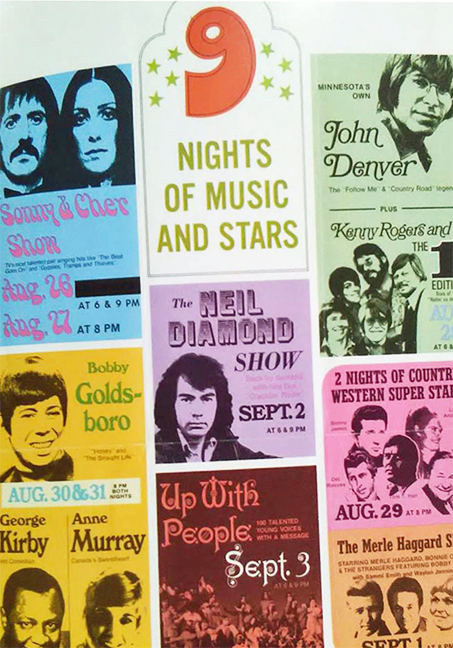
Artwork from The Minnesota State Fair: An Illustrated History. Thanks to Kevin Pates
CHILDREN’S DAYS 1972
Children’s Days were held on August 25 and September 1. The Annual Report was short on details of the special Grandstand shows.
ADMINISTRATION PARK BANDSHELL
This bandshell was built in 1971 and performances were free. Some of the performers in 1972 were:
- The Betty Rydell Trio
- North Door
- Caldwells
- Blly ThunderKloud and the Chieftones
- The Trinidad Tripoli Steel Band
- Di Martinos
- Jack D’ Johns
- Fair Tyme Singers
YOUNG AMERICA CENTER 1972
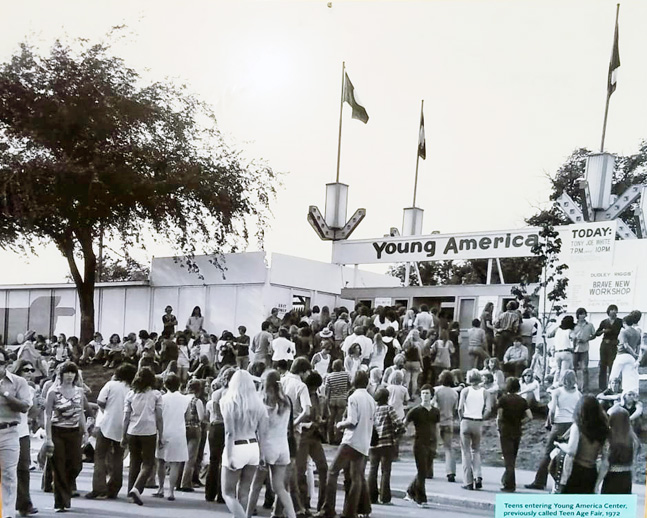
“Teens entering Young America Center, previously called Teen Age Fair, 1972”
The following is the schedule of national performers at the 1972 Young America Center:
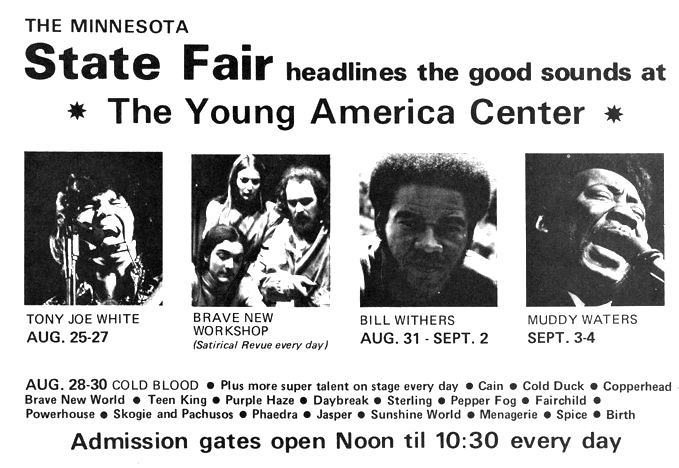
Brave New Workshop (Satirical Revue every day)
August 25-27, 1972: Tony Joe White
August 28-30, 1972: Cold Blood. Cold Blood was “a jazz-rock band that has some national fame. Lead singer Lydia Pense’s style was compared to that of Janis Joplin…. Remarkably, Lydia Pense and Cold Blood still performs today.”
August 31 – September 2, 1972: Bill Withers
September 3-4, 1972: Muddy Waters
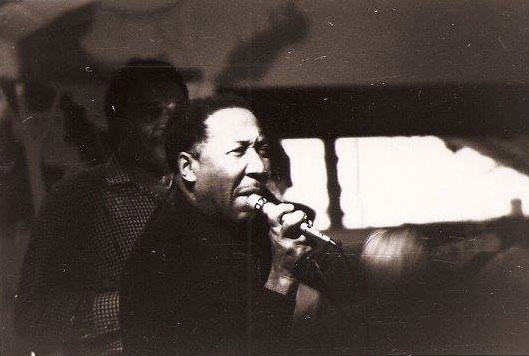
Muddy Waters – Photo courtesy Randy Nordquist
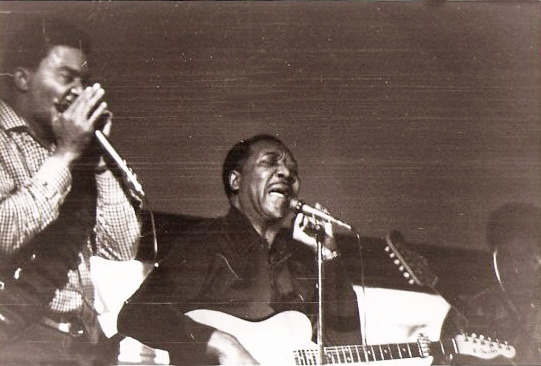
Mojo Buford and Muddy Waters. Photo courtesy Randy Nordquist
Also appearing were the biggest of the local bands, as reported by the Insider:
- Litter
- Pepper Fog
- Cain
- Cold Duck
- Copperhead
- Teen King and the Princes
- Purple Haze
- Daybreak
- Sterling
- Octopus
- Blackbone
- Danny’s Reasons
- Fairchild
- Powerhouse
- Skogie and the Flaming Pachucos
- Phaedra
- Jasper
- Sunshine World
- Brave New World
- Menagerie
- Spice
- Birth
1973
GRANDSTAND SHOWS
- August 24: Demolition Derby
- August 25: Mac Davis with the Fifth Dimension (2 shows)
- August 26: Mac Davis with the Fifth Dimension
- August 27: Dawn featuring Tony Orlando with the Brady Bunch Kids (2 shows)
- August 28: Bill Anderson, Donna Fargo, Tommy Overstreet, Leroy Van Dyke, and comedian Jerry Clower
- August 29 and 30: Pat Boone Family and Rich Little
- August 31 and September 1: Engelbert Humperdinck with nightclub comic Morty Gunty** Humperdinck fell ill and was not replaced – these Grandstand shows were cancelled.
- September 2: Charley Pride, Johnny Russell, and ventriloquist Alex Houston and Elmer (2 shows)
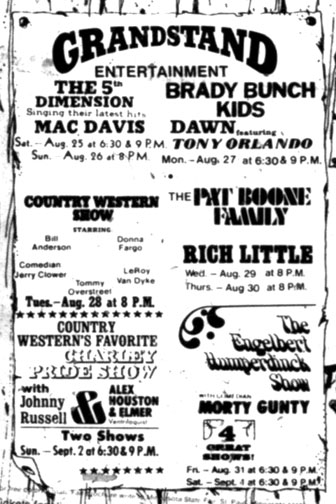
White Bear Press, courtesy White Bear Historical Society
** In case you wondered about Morty Gunty, he appears to be straight outta da Catskills.
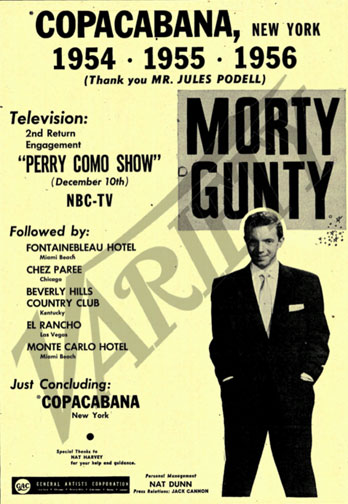
CHILDREN’S DAYS 1973
The first Children’s Day was held on August 24. At 9:30 at the Grandstand kids under 16 were treated to a show featuring:
- Candy Candido
- Holter’s Wild Animal Show
- Little Angels of Korea
- Merlin the Magician
The second Children’s Day was on August 31, with the same line-up for entertainment.
ADMINISTRATION PARK BANDSHELL
This is probably an existing venue with a sponsor’s name attached to it these days. In 1973 it was a fairly active music venue. Based on State Fair Schedules published in the Minneapolis papers, the following are some of the (presumably all musical) acts presented at the Bandshell:
- Harry Blons and His Gentlemen of Dixie
- Primo People
- Jack D’Johns
- Musical Harts
- Just Two Plus One
- Don Cavitt’s Sounds of the ’30s and ’40s
- Amateur Talent Contest
- Benny Dixon and the Rebels
- Michael Harris
EDUCATION BUILDING
The State Fair Schedules published in the newspapers show musical acts taking place in the Education Building. Some assumptions are made on my part.
- Rex Accordion Band
- The Reedy Family
- Jimmy Lee and the Lee Sisters
- Star Promenaders and Jr. Lost Corners
- Tom Bednars
- America
** It should also be noted that the Ted Johnson Trio performed daily at the Hippodrome Exhibit area.
YOUNG AMERICA CENTER 1973
In the ten years since its inception, almost one million people were admitted to the Young America, at 50 cents a ticket except for 1965 when the price went up to 75 cents after 6 pm.
The 1973 State Fair youth pavilion listed three “up and coming national acts” and many other local acts on its schedule. Those considered up and coming in the Annual Report are indicated in red.
Gates opened at noon every day.
August 24
Minnesoda: Afternoon
Zulu: Afternoon
Spice: Evening
Harris Nelson, Comedian: 3:45 pm and 8:30 pm
Joy of Cooking: 6 and 10 pm
August 25
Open Road: Afternoon
The Reasons (Danny Stevens appeared naked in the September 1973 issue of the Insider): Afternoon
Cain: Evening
Harris Nelson, Comedian: 3:45 pm, 8:30 pm
Joy of Cooking: 6 pm, 10 pm
August 26
Salt, Pepper & Spice (“Funky as Hell”): Afternoon
Fairchild: Afternoon
Brave New World: Evening
Harris Nelson, Comedian: 3:45 pm, 8:30 pm
Joy of Cooking: 6 and 10 pm
August 27
Purple Haze: Afternoon
Volcano: Afternoon
Sterling: Evening
Harris Nelson, Comedian: 3:45 pm, 8:30 pm
Joy of Cooking: 6 and 10 pm
August 28
Blackbone: Afternoon
Minnesoda: Afternoon
Coal Duck: Evening
Harris Nelson, Comedian: 3:45 pm, 8:30 pm
Gypsy: 6 and 10 pm
August 29
Jesse Brady: Afternoon
Sterling: Afternoon
Zulu: Evening
Harris Nelson, Comedian: 3:45 pm, 8:30 pm
Gypsy: 6 and 10 pm
August 30
Cain: Afternoon
Rudy (“5 Pieces that will blow your mind”): Afternoon
Evening: BeBop and the Hubcaps: Evening
Bobby Smith, Comedian: 3:45 pm, 8:30 pm
Gypsy: 6 and 10 pm
August 31
The Reasons: Afternoon
Rose: Afternoon
Blackbone: Evening
Bobby Smith, Comedian: 3:45 pm, 8:30 pm
Flash Cadillac and the Continental Kids: 6 and 10 pm
The schedule kind of peters out here, but the list in the Insider does include:
- Dean Carr
- Sean Blackburn
- Joyce Everson
- Michael Stone
This is all I found of the last three days:
September 1
Bobby Smith, Comedian: 3:45 pm, 8:30 pm
Flash Cadillac and the Continental Kids: 6 and 10 pm
September 2
Bobby Smith, Comedian: 3:45 pm, 8:30 pm
Flash Cadillac and the Continental Kids: 6 and 10 pm
September 3
Bobby Smith, Comedian: 3:45 pm
Flash Cadillac and the Continental Kids: 6 pm
On Thursday, August 30, 1973, the Minneapolis Star reported that business was way down in the Young America Center, perhaps because teens didn’t have any money in this Recession year.
WAITING FOR MARCIA
And we love to share stories, so here’s a good one from Dan Chinander:
In the early 1970s on a hot and muggy Minnesota morning, my friend Gary and I got to the Minnesota State Fair bright and early. The early entry was to secure a front-row seat on the Dialing for Dollars TV show, hosted by Jim Hutton and Jane Johnston. What was so important to bring two junior high kids to stake out a seat three hours before the show? Marcia Brady! In fact, the entire Brady Bunch was going to be on the show that morning.
Taking a city bus all the way from South Minneapolis, we arrived at the fairgrounds right at 7AM. As soon as they opened the gates, we made a fast beeline to the outdoor stage. With several park benches surrounding the stage, we plopped our little butts down on the dew-soaked bench – row 1 and dead-center of the stage.
Gary and I knew we had a long wait, but it would be well worth it. Within 10 minutes an old man casually walks up and sits down next to us saying, “Hello Fellas! What brings you to the fair so early?” “The Brady Bunch!,” we replied. The man went on to say in a kind and gentle voice, “Oh, The Brady Bunch, they’re a great group of kids.”
By now I knew that voice and I asked him, “Are you Red Skelton?” “I am”, He replied. My jaw dropped and with excitement I told him how we always watched his weekly TV shows and that my favorite characters he played were, Clem Kadiddlehopper, Freddie the Freeloader and the Hobo/Clown. After about a half-hour chat, which included a few life lessons and how we should treat people, he shook our hands, got up and said goodbye.
Gary and I were so amazed that he would actually take the time to sit down and talk with us, that for a moment we forgot all about Marcia Brady! But that didn’t last very long, and what seemed like an eternity, it was finally showtime.
After a few minutes of greeting the crowd, Jane Johnstone introduced the Brady Bunch. As like in the movies, all realistic motion went to slow motion when my eyes spotted Marcia walking onto the stage. She flung her blond hair over her shoulder and then sent me a direct smile before taking her seat. I nearly melted on that bench when her eyes met my eyes that I didn’t even remember any of the interview.
Their time on that stage went by so fast and after a round of applause, the Brady Bunch exited stage left and walked into an RV that was sitting behind the stage. Gary and I spent the rest of the day eating mini-donuts, going on rides, and catching the side-shows including, “Myra the girl without a head.” The whole bus ride back to South Minneapolis Gary and I argued who Marcia gave the smile to. And I think to this day we each think her smile was directed to ourselves.
1974
GRANDSTAND SHOWS
- Liza Minelli: August 23 (2 shows)
- Redd Foxx, Demond Wilson, Slappy White, Gerri Granger, Harry “Sweets” Edison and the Little Steps: August 24 (2 shows)
- Charlie Rich and the Treasurers with Jim Stafford: August 25 (2 shows)
- Demolition Derby: August 26
- Jerry Reed, Tanya Tucker, Jerry Clower, Judy Lynn, and Hank Snow, August 27
- Bob Hope with Danny Davis & the Nashville Brass and Dian Hart, August 28
- Jim Nabors with the Hager Twins from Hee Haw: August 29
- Mac Davis with the Fifth Dimension: August 30
- Roy Clark, Buck Trent, Diana Trask, The Spurrlows, Jerry Clower: August 31
- Helen Reddy with Jose Feliciano: September 1 (2 shows)
CHILDREN’S DAY 1974
Details on Children’s Days were few in the Annual Report, but did state that the entertainment featured Texas humorist Randy Brown.
ADMINISTRATION BANDSHELL
Among the groups appearing for free at the Administration Bandshell were:
- Billy ThunderKloud and the Chieftones
- Jack D’Johns
- Don Cavitt”s Sounds of the ’30s and ’40s
- Kithara
- Conti Family
- Main Street Singers
- The excellent and under-appreciated Larry and Lorrie Collins, with the Oklahoma River Bottom Band
- Amateur Talent Contest
OTHER ENTERTAINMENT (based on schedules printed in Minneapolis papers)
Education Building:
- Rex Accordion Band
- The Reedy Family
Hippodrome Exhibit Area:
- The Ted Johnson Trio performed daily
Machinery Park:
- Chatfield Brass Band
Territorial Pioneer Log Cabin:
- John Mandernach Sextet
- Mike Rasmussen’s Folk Singers
- Evie Gulden, country-western singer
YOUTH EXPO ’74
The Young America Center was renamed Youth Expo ’74 and Music Festival, sponsored by KSTP and Schon Productions. Admission was doubled to $1 but 25 cent coupons were easy to find. Gates opened at noon.
Promoters were trying to breathe some life into the dwindling youth center, which peaked in 1966 with 115,000 attendees to a low in 1973 of 78,000. Although the newspapers printed plenty of ads for shows, the official State Fair Schedules provided no information as to which bands might be playing. The only information given in the schedules was the time the Youth Expo opened, and that shows were at 1, 3, 5, 7, and 9 pm.
The Insider‘s description of the grounds was bleak: a chain link fence surrounding a sheet metal and concrete shelter staging area. Scott Browning didn’t agree:
The Teen Center was a fun place to hang out. All day music on site, Record Stores, Clothes Shops, Hippy Boutique items, Black Light Posters, Jewelry. Really sad that they closed that area down.
*Find Out What’s Happening With the Under 30 Crowd at the Market Place. Exhibits Include:
- Stereo-Audio
- Camping
- Records
- Clothing
- Skiing
- Bicycles
- Mountain Gear
Dave Bowman:
My favorite part in the Teenage Fair (Young America Center) were the local booths that all the musical instrument shops had set up, like B Sharp and Vavro’s. You could play their guitars and drums, and local bands would sit in and play a few songs or a set. Totally cool…

YOUTH EXPO ’74
The former Teen Center, then Young America Center, changed its name to Youth Expo ’74. Admission went up to $1, but there were lots of discount coupons.
ENTERTAINMENT, DAY BY DAY, HOUR BY HOUR
The following schedule and groovy commentary comes from a full-page ad in the Twin Cities Express magazine.
August 23
1: Skogie
3: Fresh Start (Los Angeles studio musicians)
5: Kansas. You may have seen Kansas with Chicago and the Doobie Brothers and Fresh Start with Bachman-Turner Overdrive. Both energy-packing bands will provide for quite an afternoon warm-up.
7 and 9: Charlie Daniels Band. Daniels closely associates himself with one of the most dynamic developments on the contemporary scene, “Southern Music,” that hard-to-define, but unmistakable brand of music now coming from the South.
August 24
1: Rose
3: Fresh Start
5: Kansas
7 and 9: Charlie Daniels
August 25
1: Jesse Brady
3: Fresh Start
5: Kansas
7 and 9: Charlie Daniels
August 26
1: Natural Life
3:30 Isis (eight-piece female jazz-rock group)
5: Renaissance (Progressive Rock)
7:30 and 9:30 Freddie King. Uptight, upfront, and the no. 1 heavy bluesman, Freddy King is knocking on our door. If you’ve tasted the good time of the bluess before, you’re set. If you haven’t, baby, this is one show that will teach you what Boogie really means. Get down!
August 27
1:30 Rush – Canadian rock – a newcomer to Minnesota and quick to grow. A group we are glad to introduce. This Rush will soon be a stampede.
3:30 Isis – 8 brass-blowing rock n’ roll women who cook their own brand of music. This dinner for 8 is considered the best women band ever; the hottest new brass band of ’74.
5: Renaissance – rock music in depth. Special in their music and style. Combine their English presence, a touch of Yes, ELP, English folk, and the mastery of their ability, and this may be the best “new” band from England yet.
7 and 9: Freddie King
August 28
1:30 Rush
3:30 Isis
5: Heartsfield, (Chicago-based country blues)
7 and 9: Freddie King
August 29
1: Uncle Vinty
3:30 Isis
5: Heartsfield
7:30 and 9:30 Wet Willie – BAAAD mothers! Said with a capital B. Wet Willie is taking the country by storm. They’re hot and ballsy. “Keep on Smiling” is the tip of the iceberg. Underneath you will find a band that is stoning people coast to coast to coast. Get there early for this one ’cause the crowd will be shakin.’
August 30
1: Straight Up
3:30 Isis
5: Heartsfield. Six people who dig music in all shapes and forms are Heartsfield. There won’t be one persson sitting in the Expo. Stand up and shake it!
7:30 and 9:30 Wet Willie
August 31
1: Gypsy
3:30 Hydra-new, hot and hard-Macon, Georgia rock n’ roll. Hydra is not coming up to fool around. Their music rocks long, loud and hard.
5: Larry Raspberry and the Highsteppers, (“rock ‘n ‘ roll septet from the South”), have done more to promote dancing in Memphis than anyone since Arthur Murray opened his studio downtown. With their fine singola-boogie rock n’ roll, they’re crowd killers and they’ll kill you. When Larry was booked into the show his only comment was “We are very much looking forward to this date as we plan to knock everyone’s XXX off!!!”
7:30 and 9:30 Wet Willie
September 1
1: Skogie
3:30 Hydra
5: Larry Raspberry and the Highsteppers
7:30 and 9:30 New York Dolls – what the Big Apple of New York is all about. The Dolls are going to hit and hit hard. Their press is incredible and response is overwhelming. Rock n’ roll 1974 is the New York Dolls. You’ve never seen anything like it. If you feel it in you, dress for the affair.
September 2
1: Osage Lute
3:30 Hydra
5: Larry Raspberry and the Highsteppers
7:30 and 9:30 New York Dolls
NEW YORK DOLLS INVADE THE FAIR
Bob Protzman of the Pioneer Press did his best to prepare the Cities for the Dolls; he said one local promoter said “he couldn’t wait to see the expressions on the faces of the State Fair’s hierarchy when they get a look at the New York Dolls in their platform shoes, bright red lipstick, earrings, tights, occasional miniskirts, necklaces, bracelets, unisex hairdos, and the rest.” He also prepared us for David Johansen’s routine of “tying up his arm and injecting himself with an imaginary hypodermic needle while singing ‘Looking for a Kiss.’”
The band was two hours late: a) no cabs would pick them up from Downtown; b) they had to be “dragged in from a drunken stroll down the midway;” or c) two of them had wandered off to get something to eat, take your pick. When they arrived they were reportedly ticked off that they were not playing in the Grandstand.
Randy Levy at Schon Productions booked the show.
Memories of the show: (There were two shows each day (September 1 and 2), so audience size and reaction may have differed between them.)
Paul Metsa:
The Dolls were late, and when they arrived and started playing they were greeted by some with beer cans and burning paper airplanes. They were all wearing eye makeup . . . (Blue Guitar Highway, 2011)
David Johansen had on bright red lipstick, Johnny Thunders prowled the stage, and Arthur Kane was in a pink tu-tu and I guess in a show of solidarity for us from this northern clime, a pair of big white bunny boots. The music seemed both ramshackle and rocking. I didn’t know quite what to make of it musically, but I dug the spectacle and had a tale to tell for my buddies back up on the Iron Range. (As told to Jim Walsh in Walsh’s piece “Midway Memories,” minnpost.com, August 24, 2017)
Tom Rusch’s review in the Insider did note that “this was no fey glam rock.”
Chris Osgood shared this story with Jim Walsh for Walsh’s piece “Midway Memories,” minnpost.com, August 24, 2017:
Johnny Thunders had a slingshot in his back pocket . . . I was impressed that the Dolls were such poor players. I had never sen a band that had a major label deal that was so sloppy and instrumentally at the 7th grade level. It was revelatory to me that they were so bad musically and so great philosophically.
Gregory Schilling:
I was at this show. It was quite a strange bill. If I remember correctly it was Larry Raspberry and the High Steppers, then packed to the walls show with Kansas. Then the place rather cleared out and out sauntered the New York Dolls. I was like 10 or 11 years old. Loved the Dolls then and now!
Daniel Flies:
At the end of their set, they gave away WHITE BALLOONS with their “New York Dolls” logo on it in LIPSTICK. They were all over the teen center.
Scott Browning also remembers tubes of glitter they were handing out.
Robin Goldstein: “Packed house of raucous fans. It was great.”
CP Lawson, perhaps thinking Minnesotans were rubes: “ It was called the Teen Barn. The farmers in bib-overalls had a hard time with it as the band, including Johnny Thunders, wore fishnet stockings, heels and lipstick!”
Lorna Doone (when asked what her best concert was):
OH! How could I ever forget those two days of the NEW YORK DOLLS playing the Teen Pavilion in 1974 @ the MN STATE FAIR? I was dancing on the picnic tables, out of my mind w/the Love of Rock music!
Jeff Miletich:
I remember when the New York Dolls were overhyped and played at Young America. By the third song most (a couple of hundred people) had walked out. They sucked that bad. David “Buster” Johanson has never had an ounce of talent.
After the show the boys went off to enjoy the Midway.
Scott Browning adds that the NY Dolls “were scheduled to do a show at the Orpheum Theater for the first album in 1973 but it was cancelled due to poor ticket sales. I was a big fan of them I don’t ever recall any other Twin Cities dates scheduled for them.” The official reason given for the cancellation was that bassist Arthur Kane had a “thumb injury,” according to Billboard. Jim Froehlich remarked, “Arthur Kane’s “thumb injury” hadn’t healed by the following September because roadie Peter Jordan filled in for him at the State Fair as well, “thumb injury” being slang for “rehab.”
Rod Bell says that the New York Dolls concert “spawned all sorts of local bands.”
THE END OF YOUTH
The New York Dolls may have precipitated the end of the Teen/Youth/Expo Center. In 1975 the area was remodeled into an exhibit called Heritage Square, reported the Minneapolis Tribune on August 17, 1975.
The area is now the transit hub.
This giant theater with two names was located at 36 So. Ninth Street in Minneapolis.
THE MINNESOTA THEATER
We learn its history from the Cinema Treasures website:
The Minnesota opened in 1928 and was, at the time, the fifth largest theater in the country, with seating for over 4,000 in the huge auditorium. It was designed by the Chicago-based firm of Graven & Mayger in the French Renaissance style.
The three-story grand lobby was based upon the Sainte-Chappelle at Versailles, and contained a large marble staircase, rows of Corinthian columns with gilded capitals, and on the mezzanine, a grand piano played while patrons waited under an enormous crystal chandelier for the show to start.
The auditorium was even more impressive, with a large stage and a soaring proscenium arch decorated with intricate plasterwork. The ceiling was cove-lit, and the side walls also covered with gilded plasterwork. Sets of smaller chandeliers hung from the ceiling.
The seats on the main floor and balcony were upholstered with velvet. Antique paintings and sculptures filled many of the public areas.
The exterior of the Minnesota Theater was the piece-de-resistance, its facade coated in various shades of white terracotta, and topped by a spectacular domed tower at the theater’s corner entrance, with decorative polychromed terracotta floral patterns all the way down its side. These were traced by lighting and illuminated at night, as was the dome.
The vertical marquee was eight stories tall, spelling out the theater’s name in huge white letters. The marquee over the main entrance was equally ornate, wrapping around the corner of the building, forming a triangular shape. Like the terracotta on the tower above it, it echoed the floral pattern shape in its neon signage. The word ‘Minnesota’ was encircled by a stylized fleur-de-lis pattern, in shades of green and yellow.
Not long after the Minnesota Theater opened, the Depression began, and the theater began a roller-coaster ride of closings and reopenings that would last throughout the 1930s and into the start of the 1940s.
Despite this, it featured elaborate stage reviews, vaudeville acts, and motion pictures. In 1941, Disney’s “Fantasia” had its premiere at the Minnesota Theater, and ran for much of that year. However, once Disney left, the theater once again was closed.
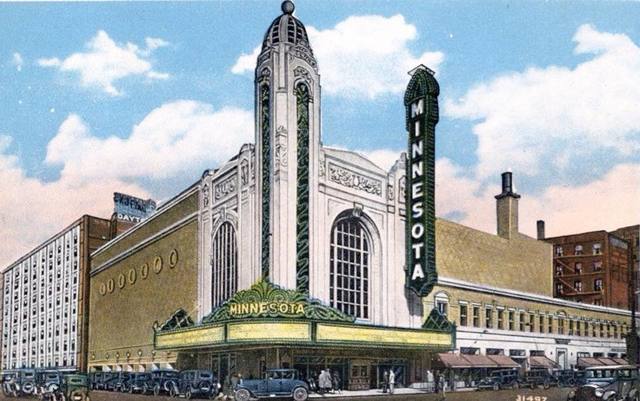
RADIO CITY THEATER
The theater reopened on March 8, 1944, renamed the Radio City Theater. According to this photo from the Minnesota Historical Society, KSTP radio began its residence in the theater on that date, replacing facilities in the Radisson Hotel. (KSTP also had studios in the St. Paul Hotel.)
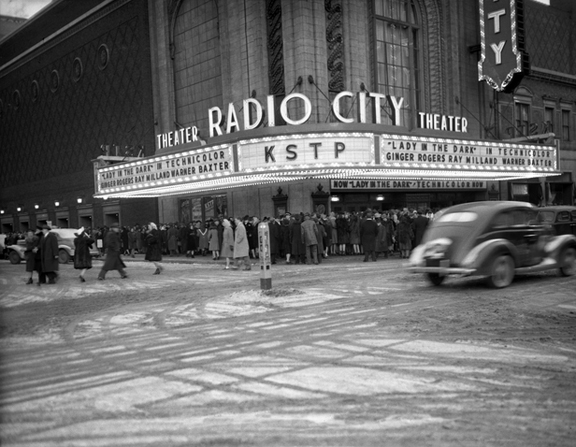
Radio City Theater, March 8, 1944 – Minnesota Historical Society
Both of KSTP’s studios moved to its current studio and office building at 3415 University Ave. SE in early 1948.
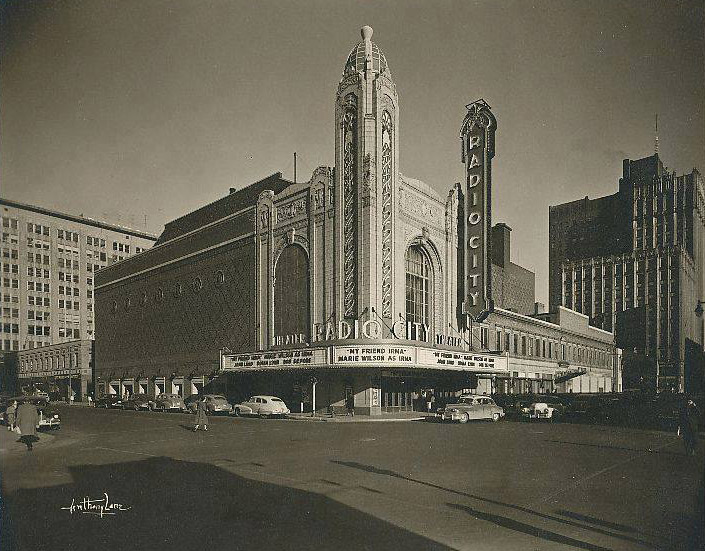
Circa May 1949
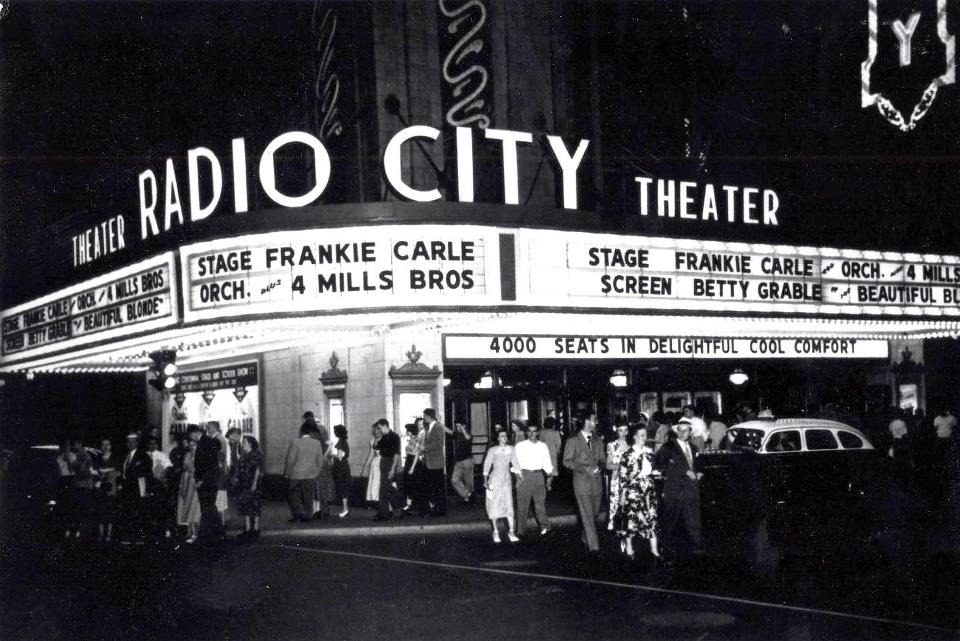
Circa October 1949
WCCO began to operate out of the Radio City Theater in 1949.
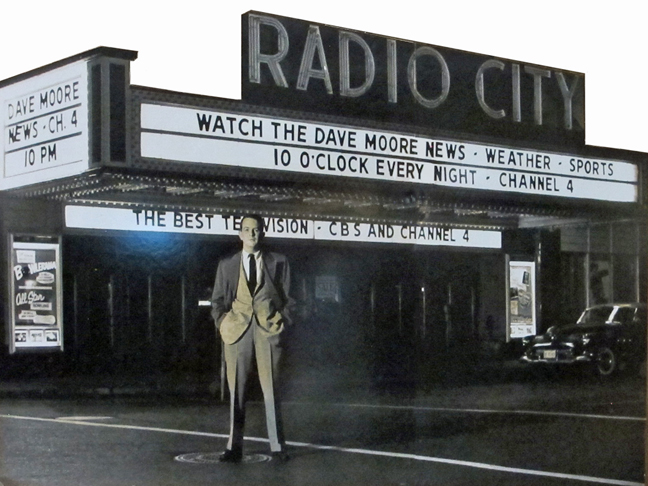
Dave Moore at Radio City, circa 1957. Courtesy Pavek Museum of Broadcasting
Radio City closed as a movie theater on October 15, 1958. The auditorium portion of the building was demolished in 1959, leaving a long narrow building at 50 So. 9th Street that exists today. A large building was built behind it in 1969, according to county property tax records.
WCCO-TV moved to a new building at 90 So. 11th Street (1017 Nicollet Mall) in 1983.
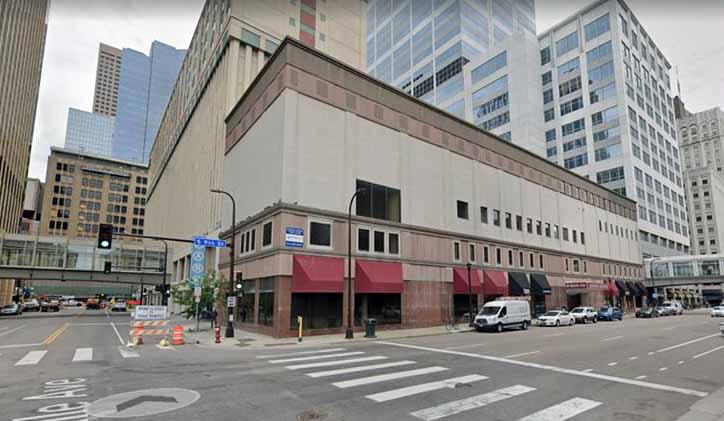
Google view of present building
341-343 E. 38th Street, Minneapolis. A September 1938 ad promised food, beverages, and entertainment, with club rooms available to organizations and clubs for meetings or entertainments. This is now a church, built in 1922.
Many thanks to the Stannard family for their help with this page!
The Minnetonka Mist was located at 4050 Shoreline Drive in Spring Park across from Lake Minnetonka. This was approximately the site of the old Hotel Del Otero, and in fact, the street behind it was Del Otero Street.
The site was first a gas station, and then a liquor store called the Bottle Basket.
Paul D. Stannard bought the Bottle Basket in 1969. (Stannard also owned Knutson Liquor in Hopkins in December 1972.)
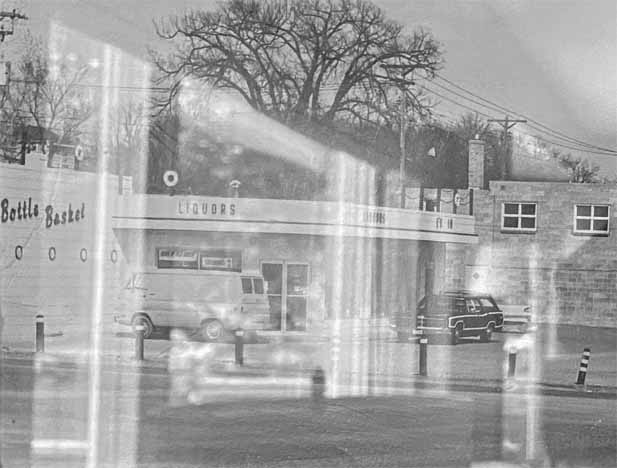
Bottle Basket – Family Photo
He then built a bar in 1970, but local ordinance required that in order to have an on-sale license, food must be served, so Stannard added a restaurant in 1971, and that was the Minnetonka Mist.
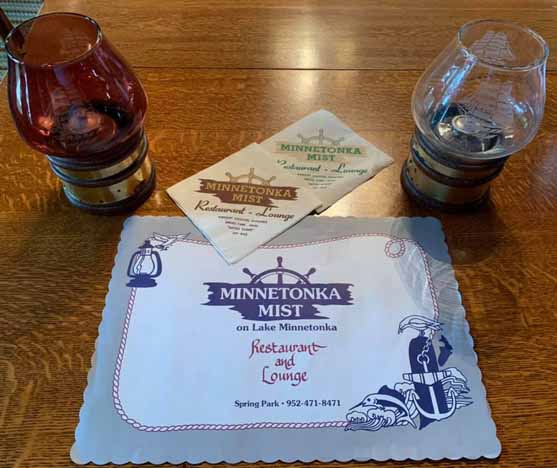
Photo courtesy Patty Babler
Paul and his wife Dorothy M. Stannard owned the Minnetonka Mist for over 35 years. Their son-in-law, Gregory J. Suddendorf, was the General Manager, also for 35 years.
With great views and great food, this was a major local hangout for all age groups. There was a deck where you could eat and look out on Lake Minnetonka that is fondly remembered. People could drive or boat to the restaurant’s dock.
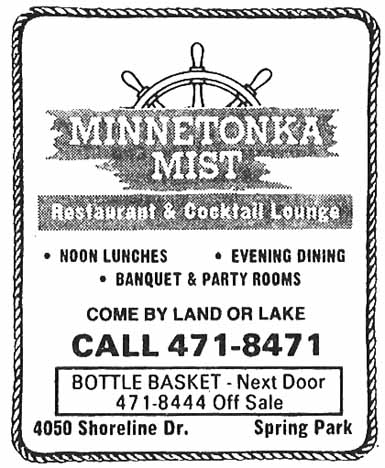
Ad courtesy James Orndorf
Dale Thomton played there in 1973 – 1974.
After Dale Thomton, there was a band called the “Road Gang” that played for many years.
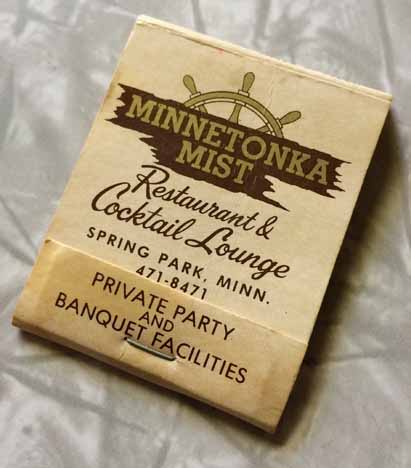
Image courtesy Greg Thoen
FROM MIST TO CONDOS
Comes a time when shorefront property becomes so valuable that there’s an irresistible urge to build condos on it. The family sold their land, and the restaurant’s fixtures were auctioned off in September 2004.
A 120-unit condo building called the Mist was built in 2006.

The Minor Key was located at 323 14th Ave. SE, near the University of Minnesota.
GOPHERLAND CAFE
The building dated to 1911, and housed stores and cafes catering to students at the U. From at least March of 1952 it was the Gopherland Cafe.
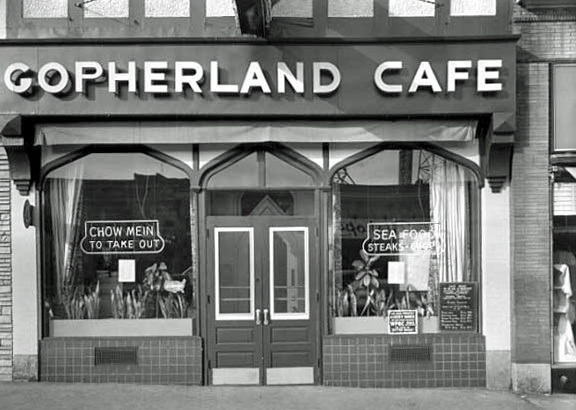
Photo dated November 3, 1956, courtesy Minnesota Historical Society
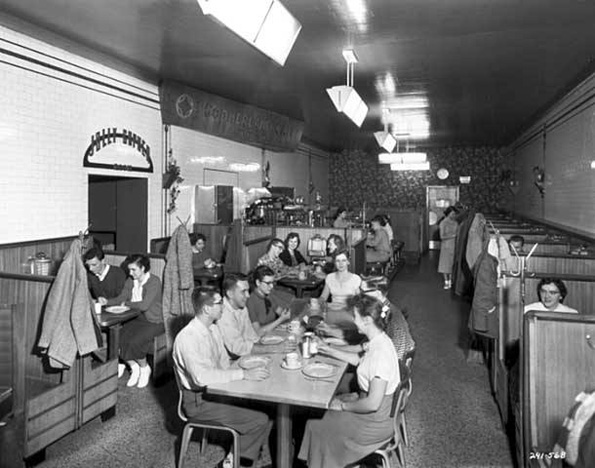
Inside the Gopherland. Photo dated November 3, 1956, courtesy Minnesota Historical Society
THE MINOR KEY
The Minor Key opened in October 1961 and was run by Irv Hechter, the brother of Connie Hechter, who would go on to publish Connie’s Insider, the quintessential music magazine of the sixties and seventies in the Twin Cities. For now, Connie was a percussionist, and his quintet performed in the basement of the Minor Key on the weekends. Upstairs, the restaurant served Kosher-style delicatessen. (Will Jones, Minneapolis Tribune, October 16, 1961)
Although plans were to hire and train only waiters, ads for waitresses soon appeared.
Concerts:
Greenwood Singers, January 11, 1962
Gene Farmer, Comedian and Folksinger, February 2, 1962
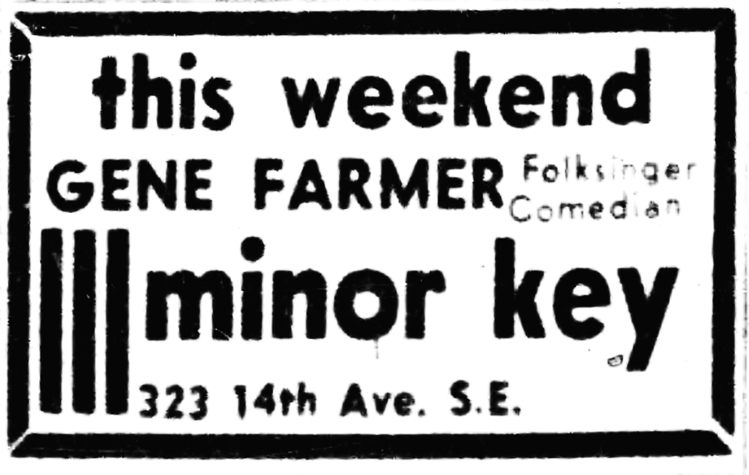
Beat Comedian Hugh Romney, (dubbed “Wavy Gravy” by B.B. King in 1969), March 2 – 12, 1962
But alas, on March 6, 1962, Will Jones reported, “Club Closes; Show Goes on”
Far-out comedian Hugh Romney opened Friday at the Minor Key and drew good business Friday and Saturday nights.
Sunday the owners of the near campus delicatessen decided they couldn’t keep open any longer no matter how much business Romney did. They’ve been losing too much money trying to peddle corned beef to U of M students during the day.
So they arranged with the Padded Cell to take over Romney’s contract. The Minor Key locked its doors and Romney opened Monday night at the Padded Cell, alternating with folksingers Ian and Sylvia. He will stay there through next Sunday.
RECORD STORES
After a short stint as the Starlite Cafe and Bakery, this location became a branch of the Discount Records chain in October 1964.
From 1986 to 1996 it was a branch of the Musicland record store chain.
Please see Hollywood Inn of Mendota.
Thank you to Alan Slacter, Buzzy Bohn, Alan Freed, and all the folks on Facebook who have contributed photos and comments to this page!
Mixer’s was located at 221 Cedar Ave. So. at Washington Ave., Seven Corners, West Bank.
The building, considered as 221 – 225 Cedar Ave. So. by the City, was constructed in the spring of 1889. It was a four story, 66′ by 76′ brick block of three storefronts with dwellings up above. Decorated with a tall, delicate tower on the corner, the building came to be known as the Tower Hotel Building.
The photo below gives another address of 1811 Washington Ave. So., which runs along the side of the building. According to the permit cards, this was a frame addition to a hotel, but perhaps not our hotel, since it was built in 1886, three years before the Tower Hotel was built. In the early 1920s there are references to the Twin City Creamery Co. The whole thing was demolished at the end of 1962 – it was described as a 36′ x 85′ x 20′ frame building.
The photo below is undated, but because it holds the Minnesota Candy Kitchen, one could assume that it was taken in or after 1920.
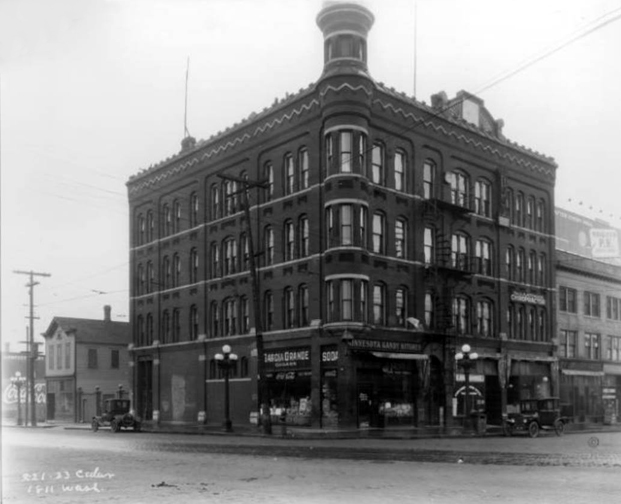
Photo by Arnold D. Roth, courtesy Hennepin County Library
SALOON
As early as 1891, and perhaps right away, a saloon was located here. From a newspaper report, we know that in April 1894, Saloonkeeper Ole Anderson was in trouble for staying open on Sunday – part of a Citywide crackdown. It is likely that the saloon lasted until Prohibition started at the beginning of 1920.
Since there were three addresses, it is a bit difficult to tell what was where when. Hints come from the city’s permit cards, but they seldom give the various addresses. Here are some activities in the building:
Barber Shop: One was in the building as early as 1895, and there was evidence in 1912. There was also a notation for a beauty parlor in 1934.
The building held a meeting hall/lodge room, as noted on the permit card in 1906. A newspaper article dated March 1916 mentioned the Grant IOOF (Odd Fellows) Lodge. I found a few other references to the Grant IOOF, but no address. The notes on the photo above say the IOOF Hall was on the third floor over the chiropractor’s office overlooking Cedar Ave.
A puzzlement is a notation on the permit card that $6,000 in repairs had to be made after a fire (permit pulled March 13, 1911), but I found no sign of what would have been a big fire on or near that day
Melia Music Store: An obituary said that this store was here (at 223 Cedar) from 1913 to 1917.
A bowling alley/pool room couldn’t have coexisted with a music store, but the permit card indicated that one was at 223 in 1913, and in 1915, the equipment was up for sale.
MINNESOTA CANDY KITCHEN
Once Prohibition came upon us, the saloon on the corner had to pack it in (or at least go underground). Notations on the permit cards indicate that it was some kind of restaurant or “store” in 1924 and 1930.
But we know that by at least June 1928, the corner spot was the location of the Minnesota Candy Kitchen. This is entirely consistent with most saloons, which turned into “confectioneries” or candy stores during Prohibition.
An ad in the South Side News in October 1934 clinches the deal. They didn’t even bother to change their name after Prohibition made whatever they had been doing under the guise of being a candy shop legal. Anyway, their ad touts wines, liquors, 6% beer, Fried Chicken and Steak. Dine and Dance!
In May 1935, there was the New Candy Kitchen, perhaps with new owners.
MINNESOTA GRILL
By June 1936, the place was the Minnesota Grill. A newspaper search found absolutely nothing extraordinary about it – no ads, no dining, no dancing. Just a bowling team, wantads for waitresses, and a few burglaries. The Minnesota Grill held the spot on the corner until at least May 11, 1959.
TOWER HOTEL BUILDING FIRE
At 12:30 pm on November 26, 1950, fire broke out in a lower floor of the Tower Hotel Building and swept up the air shaft to mushroom and trap residents on the fourth floor. The 27-degree weather and brisk winds whirled smoke over the area turned Seven Corners into a scene of confusion, reported the Minneapolis Star. More than 75 residents groped their way to safety, many rescued by firemen on ladders. Water poured into the structure quickly turned to ice. The fire was brought under control by 3 pm, after most of the city’s equipment had been called to fight it.
Four residents of the hotel died in the fire, all trapped on the fourth floor. Their ages ranged from 45 to 70. Another woman’s hands were severely burned, two firemen were overcome by smoke, and five people were treated for minor injuries, including the building manager and his wife. (Minneapolis Star, November 27, 1950)
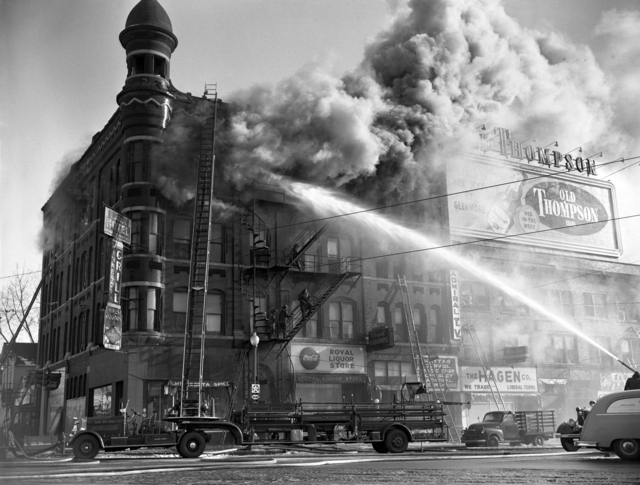
Tower Hotel Building fire, November 26, 1950. Photo courtesy Minnesota Historical Society
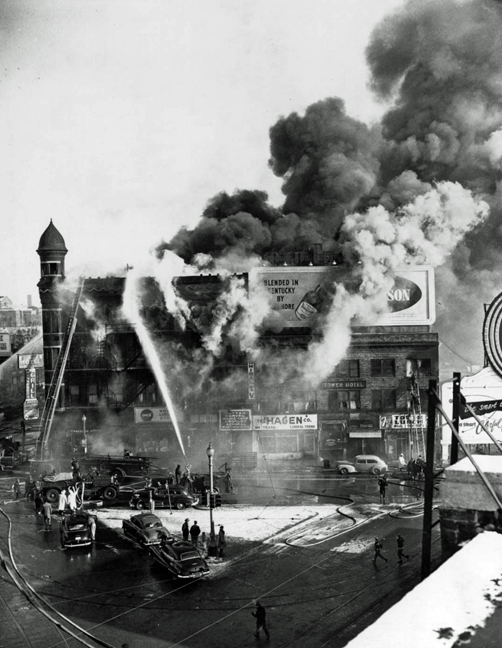
Tower Hotel Building fire, November 26, 1950. Photo courtesy Hennepin County Library
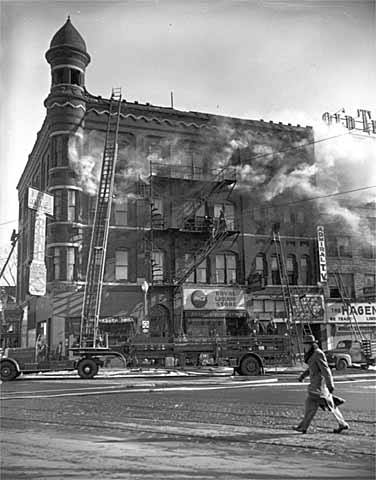
Photo Courtesy Minnesota Historical Society
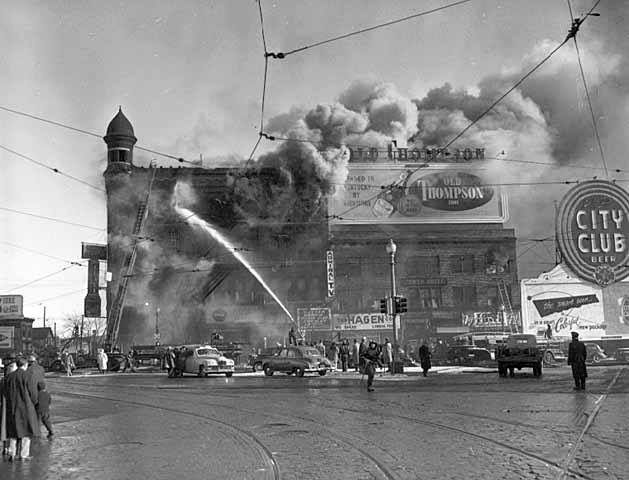
Photo Courtesy Minnesota Historical Society
Permits for the demolition of the top of the tower and the fourth floor were pulled on December 1 and 4, 1950.
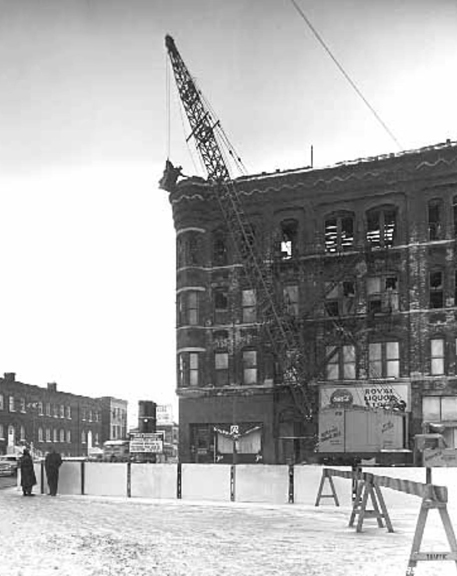
Demolition of Tower. Photo courtesy Minnesota Historical Society
MIXER’S
Ernest B. Fairbanks and Charles A. Beckman moved into the corner space in March 1962 and got a liquor license that August. Mixer’s became a Beatnik/Hippie venue 1960s, as the University of Minnesota expanded west over the Mississippi River (the first U of M building appeared on the West Bank in 1961 and the new Washington Ave. bridge was completed in 1965). Mixer’s was referred to in detail in Erik Fraser Storlie’s book Go Deep and Take Plenty of Root (2013).
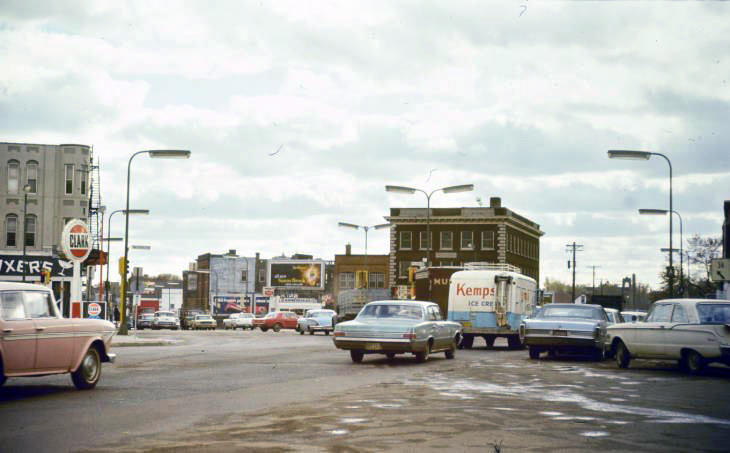
Mixer’s on the far left – 1965 Photo courtesy Hennepin County Library
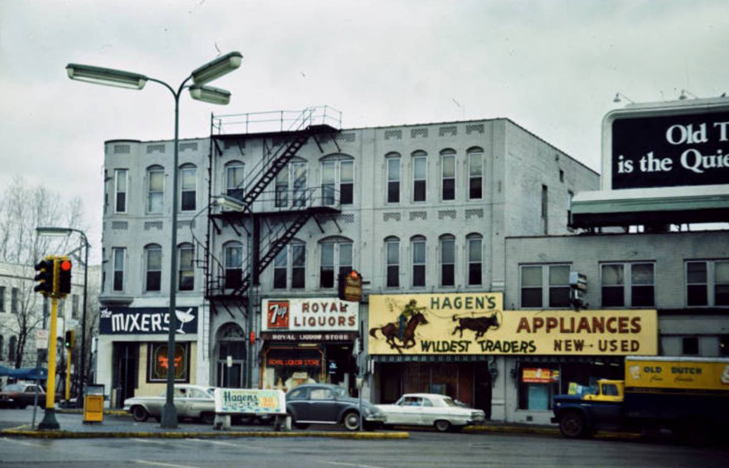
A Tower-less Tower Hotel Building after the fire. 1966 photo courtesy Hennepin County Library
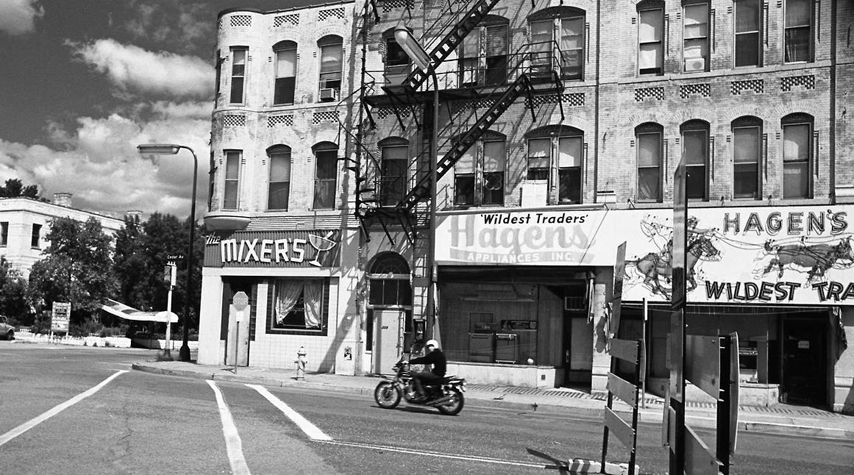
Mixer’s in the ’70s – looking a little shopworn. Photo courtesy Hennepin County Library
In 1974, Fairbanks moved Mixers to 1201 Washington Ave. So., where it was still called Mixer’s until at least 1984. He sold it in 1988; when he died in 1991, the relocated Mixer’s was known as Maxwell’s.
SERGEANT PRESTON’S OF THE NORTH
By April 1976, Mixers had become Sgt. Preston’s. An article from 1978 said that it offered no entertainment.
In 1987, Steve Mularky bought a $60,000 half-interest in the bar with $40,000 he borrowed from a drug dealer. The dealer’s brother sold Mularky cocaine, which Mularky then sold to pay off his debt. The Feds allowed Mularky to plead guilty to covering up money laundering, but they also allowed him to keep the bar in order to pay off $150,000 in debt. (Minneapolis Star Tribune, September 17, 1993)
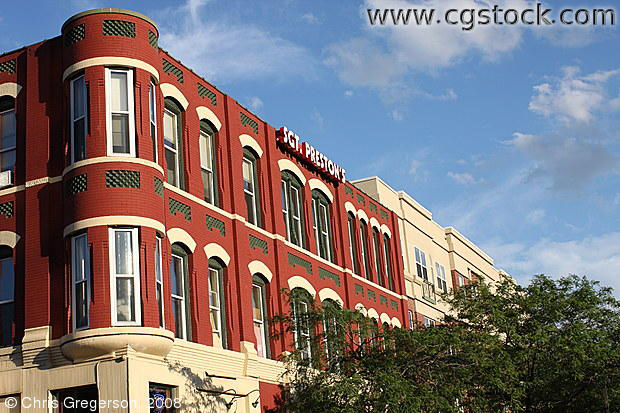
Sgt. Preston’s, 2006
PRESTON’S URBAN PUB
New owners reopened the renamed restaurant in February 2008.
REPUBLIC
In June 2011 it became Republic, opened by Matty O’Reilly and Rick Guntzel. In 2020 the website says that Matty O’Reilly is now the sole owner.
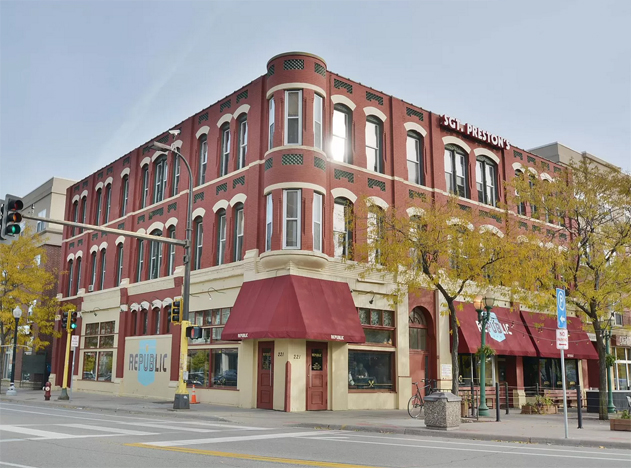
620 Hennepin Ave. was on the notorious Block E in downtown Minneapolis. It was the home of the:
- 620 Club
- Moby Dick’s
620 CLUB
The 620 Club was probably one of the seemingly thousands of taverns and night clubs that sprung up overnight at the end of Prohibition in 1933. Bob Fliegel gives the ownership timeline on Facebook – thanks, Bob!
Ernie Fliegel owned the 620 Club with equal partners Max and Henry Winter from 1934 until 1967.
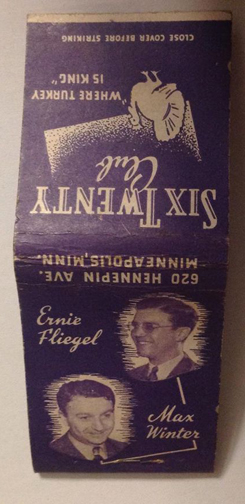
From the Collection of Mark Youngblood
Contrary to urban myth, Bob says that his dad told him that Kid Cann knew he was not welcome at the 620 Club, nor were his brothers Yiddy Bloom and Harry Bloom.
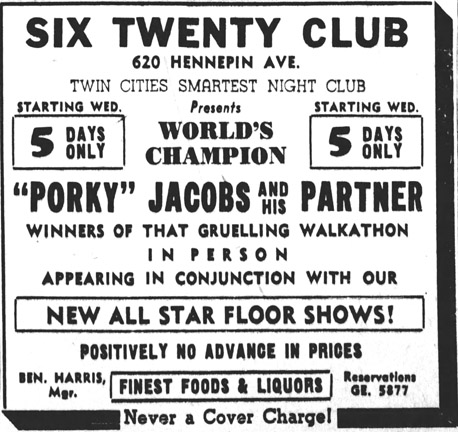
Minneapolis Star or Tribune, October 3, 1934
This ad tells us that Ben Harris was the manager in 1934.
Hard to believe the future Moby Dick’s had an orchestra and elaborate floor show!
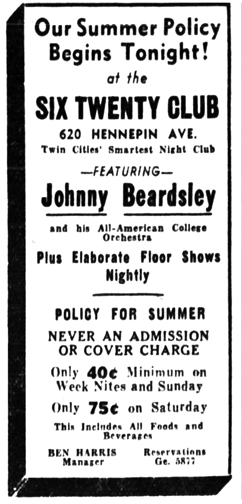
May 18, 1935
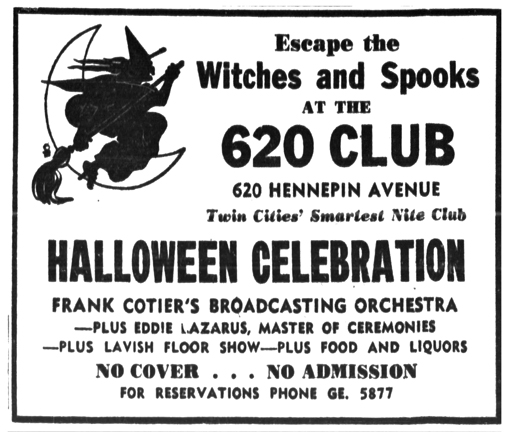
Halloween, 1935
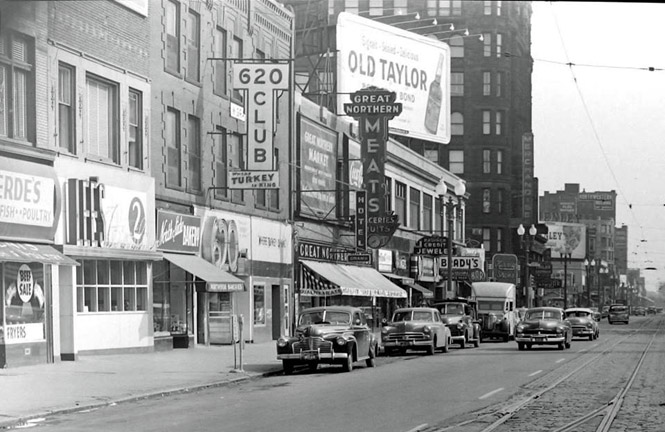
1953 Photo Courtesy Larry Bieza
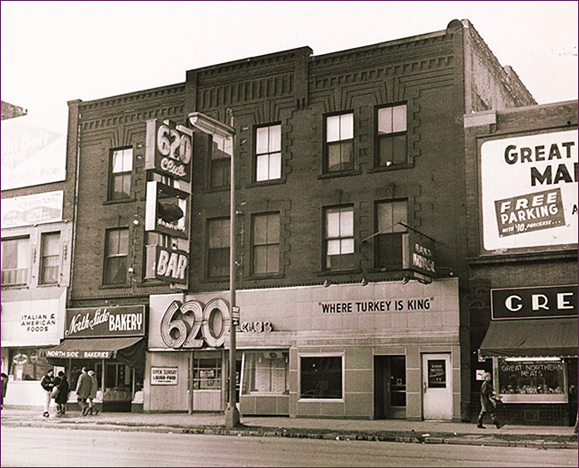
1960s photo posted by Paul Groves
WHERE TURKEY IS KING!
Turkey was the specialty of the house at the 620 Club. Below is Ernie Fliegel, on the owners, with a 22 pound turkey bound for the table of Hubert H. Humphrey, then Vice-President Elect, Thanksgiving 1964.
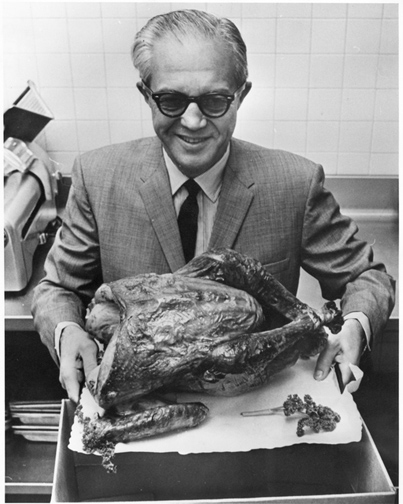
Photo courtesy Minnesota Historical Society
On September 29, 1967, Ernie Fliegel, Max Winter and Henry Winter sold the 620 Club business/license to Maxim Kunin and Sherman Richter, who retained the name of the bar & restaurant.
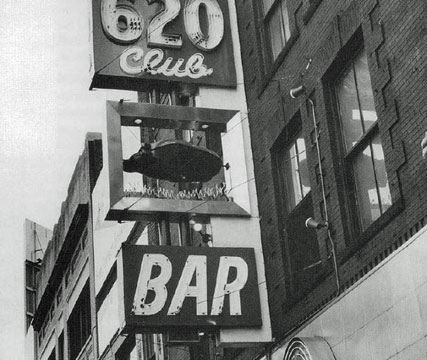
1971
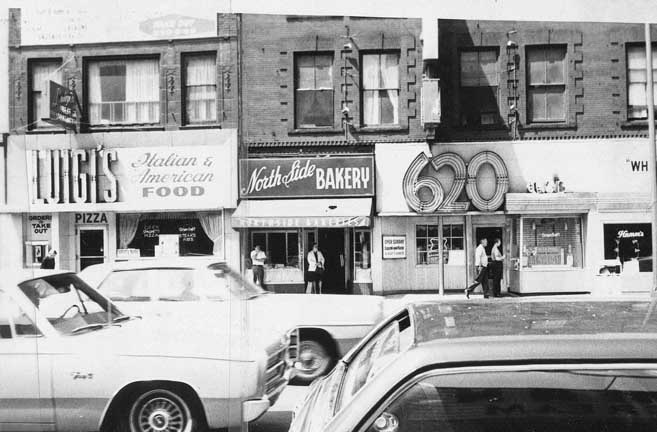
City of Minneapolis Photo
There must have been quite a run on Turkey items when the 620 went out of business, judging from all the wonderful artifacts out there!
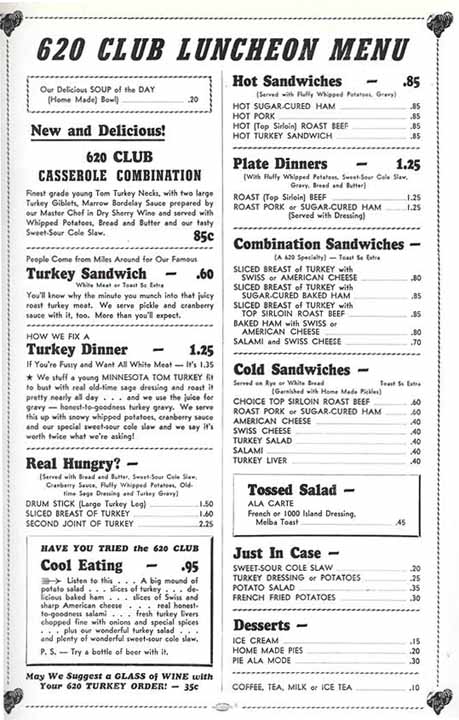
620 Club menu from December 1957, courtesy Bob Fliegel
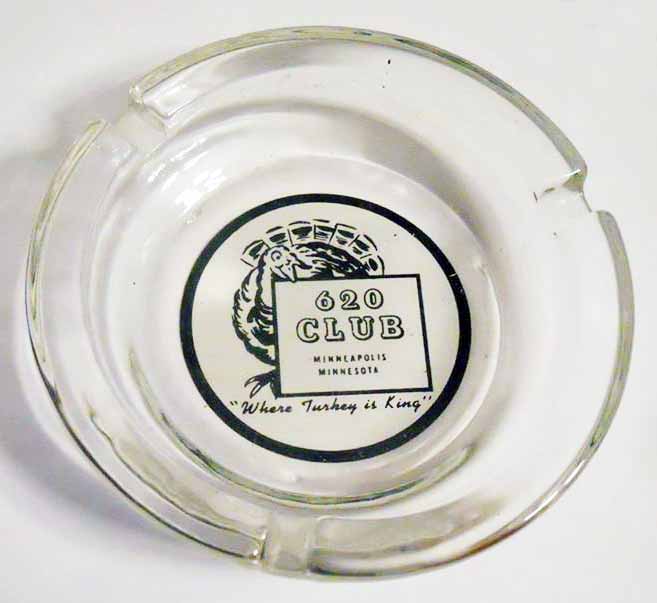
From the collection of Mark Youngblood
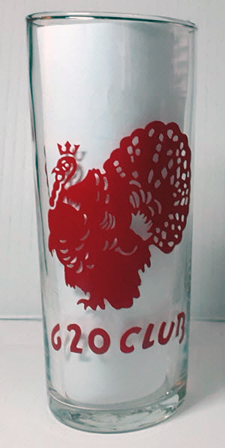
Courtesy Patricia Dale Broden Oen
If you posted these plates, please let me know!

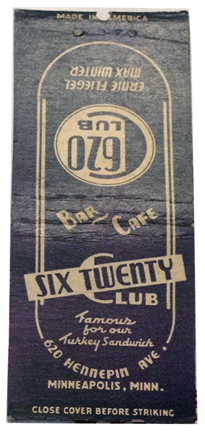
From the Collection of Mark Youngblood
MOBY DICK’S
On March 26, 1971, Kunin and Richter sold the 620 Club business/license to Moby Dick, Inc. Its new owners/licensees, Allan Cohen, Steven Gold, Robert Gold, and Kenneth “Kip” Canton changed the name of the bar to Moby Dick’s.
It was one of the places that made Hennepin Ave. so… colorful. In 1972 part-owner Canton admitted that the place “attracts a lot of hustlers, a lot of pimps, not just Mr. Nice Guys.”
Most people would admit that Moby’s didn’t have the best reputation. But an article by Dali Wiederhoft, a student from Minnetonka, described both the highs and lows of this landmark watering hole. Some excerpts:
On June 1, 1973, the legal drinking age was dropped to 18. That night, the line to get into Moby’s snaked from the front door to 7th St. to the front of the Venice Cafe. The place caught on quickly, and you could count on waiting in line every Friday and Saturday night.
Moby’s may have been the first truly integrated bar in the Twin Cities. All types of people were there: whites, blacks, Native Americans, foreigners, gays, straights, college students, Vietnam vets, any well-known musician passing through town. …
Moby’s was a bar with many firsts. War veterans who had learned to play foosball overseas flocked to it. The video game ‘”Pong” was introduced there, as were talking pinball machines. Moby’s got a national reputation as the one bar in the Twin Cities that you had to visit when in town. There was even a black market for Moby’s T-shirts.
Then, in late 1975, Moby’s began to change with the rest of downtown Minneapolis. Discos were hot, and so Moby’s added a disco to the back of the bar. What did loud music and dancing have to do with meeting people? We did just fine before. We talked to people.
The bars and restaurants downtown started having problems. As businesses closed and downtown became more and more of a ghost town, Moby’s customers began hitting “the Strip” on I-494. By the late ’70s, Moby’s had lost many of its regular customers.
For a while the troubles were blamed on the bars with strippers. Then they were blamed on the discos, then on the blacks who supposedly flocked to those discos, then on the gays, on drugs, on drunks, on street punks and finally on the homeless. (Minneapolis Star Tribune, November 12, 1988)
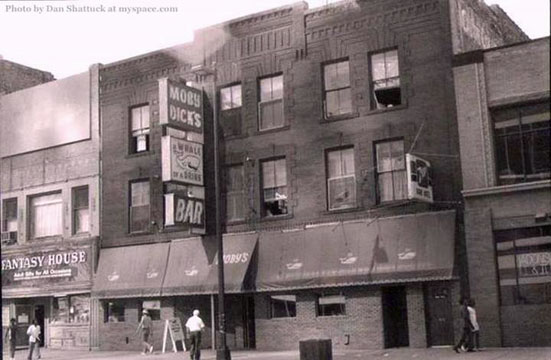
Photo by Dan Shattuck
NOT OVER YET
Drummer Bobby Vandell tells us of this ’80s respite before the end came:
There was a fairly short era in the ‘80s when live music returned to Moby’s, which we have Steve Raitt to thank for. Steve, as many know, “managed” and booked a number of popular bands in the ‘70s into the ‘80s, with Charlie “Woodchuck” Campbell, including Lamont Cranston, Willie & The Bees, The Doug Maynard Band, and The TC Jammers. Steve was always on the lookout for new venues to book his favorite bands into and he was fond of Moby Dicks and its colorful characters as a customer. At some point in the early ‘80s, Steve Raitt befriended Steve and Bob Gold, who Jeanne mentioned above as two of the clubs owners.
Armed with an over-abundance of charm, Steve had the gift of making people think that an idea they thought yesterday was the worst, was now the best idea they ever heard. I even witnessed him make them believe it was their idea. It took about a half hour for the smooth talking Raitt to convince the Gold Brothers that he should bring a concert size sound system & a hot band into the club and rock the place … And that he did. Oh … he also made them think it would be a great idea for them to promote it and pay Steve to do it. That, my friends, is the art of creating a gig out of thin air .. something you will not learn in any music school. Thanks to Steve, The Doug Maynard Band blew the roof off that joint as did The Bees and The TC Jammers.
During that era, live music venues didn’t have “in house” sound systems. The popular bands had box trucks full of sound, lights, and backline that were loaded into each club weekly as the band before packed theirs up. Steve Raitt’s system led that pack. Going to a Steve Raitt produced show was an experience like no other for listeners and a master class for other sound engineers. He brought that production into Moby’s, set it up in the front room and proceeded to give the rich landscape of characters which included pimps, hookers, thieves, gangs, dealers, hustlers an experience they never had as they navigated the dark and slightly scary real estate we knew as Moby Dick’s. I remember escorting Steve’s Sister Bonnie in there a number of times, who would on occasion, take the stage. Raitt also suggested that a space upstairs be used as a dressing room .. Let’s just say that “off limits” area created some memorable moments, as did those gigs in that very unique, rich and historical club .. Here’s to Moby Dick’s, the Gold Brothers, and Steve Raitt!
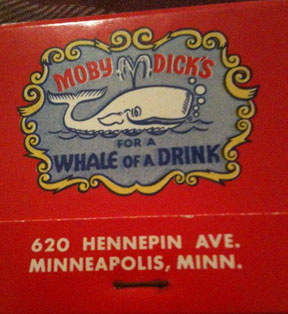
MOBY DICK IS HARPOONED
As part of the cleanup of Block E, Moby’s had to go. Fliegel: “On October 3, 1988, Moby Dick’s licensees notified the licensing dept that they were out of business as of that date.” Co-owner Gold wanted to relocate the bar to the Warehouse District (127 No. Washington) and rename it Herman Melville’s, but the artists in the Artists Quarter would have none of it.
Moby Dick’s closed for good on Sunday, October 2, 1988, and passed into legend.
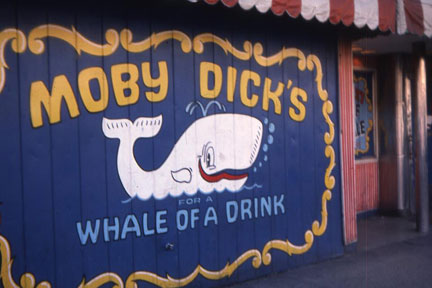
The history of the Monte Carlo turned out to be a bigger can of worms than I anticipated. It turns out that the Monte Carlo was located in three different locations. I’ll give a guess as to when they moved.
Resources
For this exercise I used the Minneapolis Star and Tribune online database, which is searchable and quite amazing. Searching for something like “Monte Carlo” will get you to the South of France, likely as not, but if you are patient and crafty you might find something.
One way to discover the history of a building in Minneapolis is to look at the permit cards, which the Hennepin County Library has scanned and put online. These are ever so much fun to read, and even with their limitations, they can still tell you much about the use of a building.
Here is the first location I found:
201-205 Washington Ave. N
According to the permit cards, this building has a fascinating history all its own. In June 1885 it was apparently built as a store, but became one of the ubiquitous saloons of Washington Ave. from 1889 to 1891. In September 1991 it’s listed as a hotel.
Now the county database says that it was built in 1900, but the card doesn’t say anything about the old structure being wrecked and a new structure being built. However, it does have a huge transformation into an amusement hall/opera house/theatre from May 1900 to 1902. Then comes a crazy back-and-forth between being a saloon and being more respectable establishments. This may have to do with Minneapolis voting wet and dry alternately, like neighboring St. Louis Park did. In between its saloon days, it could be a tailor shop, theatre, store, restaurant, and even a warehouse.
And then we find this.
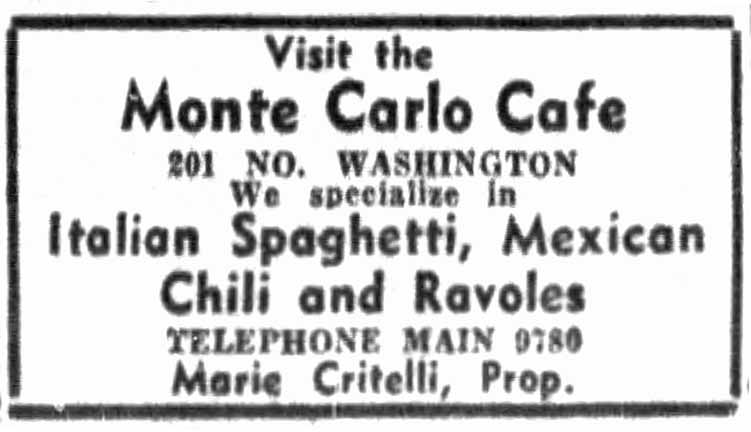
Minneapolis Tribune, November 30, 1935
Not sure what the relationship was between Marie Critelli and Steve Critelli, and not sure what a Ravole is, but this is gold! I found evidence of the Monte Carlo at this address through April 1938.
14 N 5th Street
In April 1940 there are wantads for waitresses and dishwashers at the New Monte Carlo, located at 14 N 5th Street. A look at the cards indicates that this building was built in 1884 as a store, and spent most of its life as some sort of private club? A “club room” is mentioned often, and I like the dumbwaiter. The address does not come up in the county’s database, and google gives you a picture of a waiting station for the light rail. A restaurant uses the address, but it’s part of another building that the county says was built in 1927. This location is of little importance, though, since the Monte Carlo was ensconced in its permanent location at 219 3rd Ave N by December 3, 1940.
217-219 Third Ave. N
Here’s the rundown on the current Monte Carlo. It appears to have moved to this address in December 1940, and gone by the name Monte Carlo Cafe until August 25, 1952.
A house was built on the spot in 1887, and was wrecked in 1910. In about March 1910, a Saloon and flat and store were built on the site.
An entry from 1915 shows that work was done to create a showroom, office, and warehouse in the space.
In 1917 it was briefly a hotel.
An entry from May 1920 shows it was a factory. Saloons were out at the beginning of 1920 because of Prohibition, so why not?
In August 1930 alterations were made to make it into a store.
Ah! Prohibition was over in April 1934, at least for 3.2 beer, and an entry dated April 3, 1934 shows work to make the space into a cafe. Later in July it was more specifically a bar cafe, and beer parlor.
Seems to be a gap here – in 1947 alterations were made to the storefront.
In 1949 some upgrades to the kitchen were made. Air conditioning was added in 1955.
In 1960 there were alterations to the front entrance of the “tavern and cafe,” and in 1970 there was a remodel to the second floor.
STEVE CRITELLI
In a column dated February 6, 1979, Jim Klobuchar said that Steve Critelli bought the old saloon 30 years ago, making it 1949. This is a head scratcher, since the woman who apparently started the Monte Carlo was a Critelli.
Critelli was born in Italy, raised in Brooklyn, and served honorably in World War II. He was a golfer and president of the Wirth Golf Men’s Club at one time. He was a great friend of Klobuchar, who mentioned him often in his column in the Minneapolis Star.
LIVE MUSIC
The first ad for live music I found was dated August 3, 1967. It was identical to the one below.
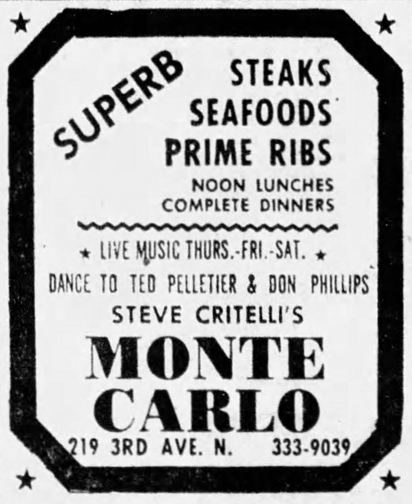
Minneapolis Star Tribune, December 9, 1967
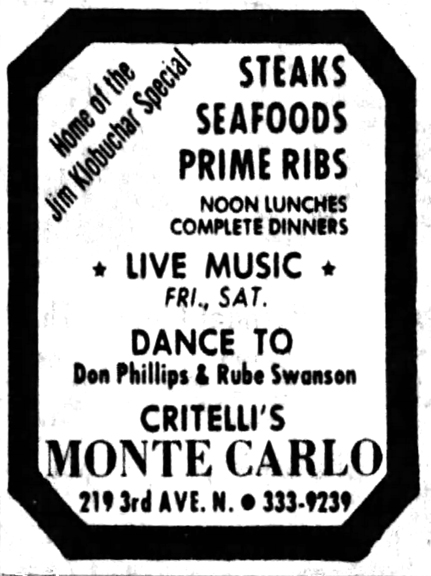
Minneapolis Star Tribune, March 27, 1971
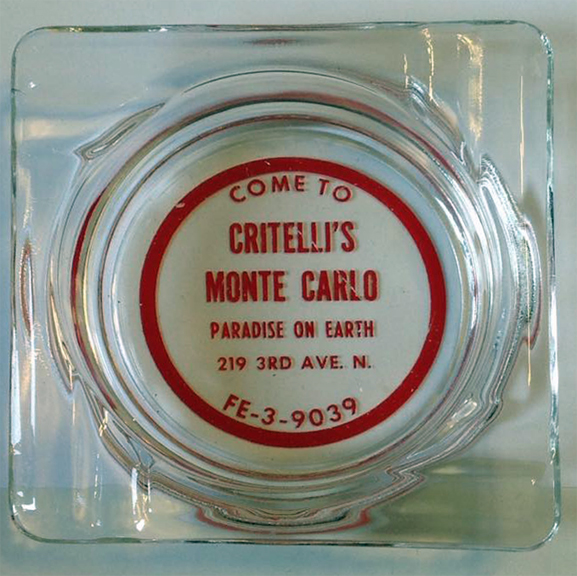
From the collection of Mark Youngblood
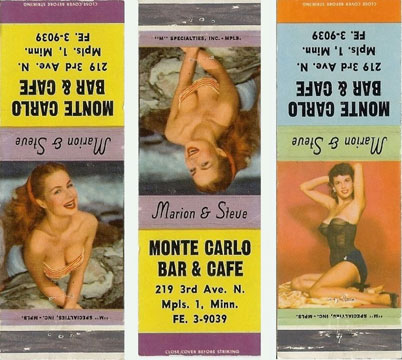
Steve Critelli sold the Monte Carlo in about October 1980. He died on November 18, 1981. His loyal friend Jim Klobuchar wrote touching columns on both occasions. Steve’s wife Marion died on October 30, 1998.
JOHN RIMARCIK
The Monte Carlo was purchased by John Rimarcik. In 1968 Rimarcik was the owner of the Peacock Tavern House and was spearheading an effort to have Minneapolis’s Patrol Limits removed from the City Charter. In 1978 he was the owner of Annie’s Parlour and the Convention Grill. In the late ’70s he was a restaurant consultant.
Rimarcik carried out extensive renovations and transformed the Monte Carlo into a destination restaurant popular with locals and tourists alike.
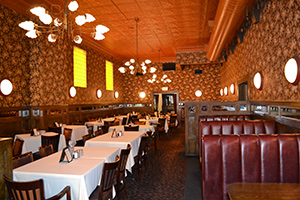
Inside of the restaurant from the Monte Carlo’s website
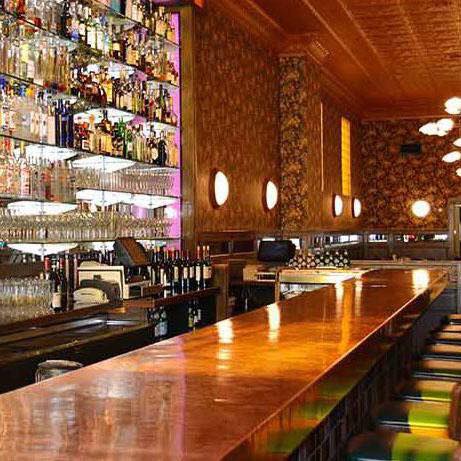
Photo courtesy Michael Leicher
This is the story of a Wigwam. Really.
Other names for this building at 729 Plymouth Ave. No. in Minneapolis were:
- Third Ward Republican Club
- Third Ward Theater
- Moonlight Gardens
- Citizens’ Protective League
- Moonlight Tavern
- Gay Paree
- Mickey’s Dine and Dance
THIRD WARD REPUBLICAN CLUB
Actually, it is the story of a building located at 729 Plymouth Ave No. in Minneapolis – the northeast corner of Plymouth and Aldrich Avenues. It was built in August 1902 by the Third Ward Republican Club – apparently these Republican clubhouses were called Wigwams.
The one-story building measured 44′ x 120′, with an auditorium capable of seating 850 people, a stage measuring 12′ by 35′, a kitchen, cloak rooms, two galleries, and apaarments for the janitor. The architect was Bertrand & Chamberlain, and it was built at a cost of $8,000. Ground was broken on August 7, 1902. The hall was dedicated in October 1902.
THIRD WARD THEATER
In 1911 the building was converted to a movie theater, Hennig Oswald, proprietor. The Minneapolis Tribune described it like this:
One enters this theater by ascending seven wooden steps. It has a seating capacity of 350; the size of the interior of the building is about 45 feet by 90. It gives four shows each weekday evening and six and seven shows on Sunday, the additional shows being given afternoons.
There are two double doors at the front of the building, one larg door opening on to Aldrich avenue, and no exit at the rear.
The two aisles are three and one half feet wide. The machine is operated over the box office at the front of the building and the booth is reached by ascending a flight of wooden steps from one side of the auditorium. The building is enirely of wood. The interior of the building gives the general impression of being roomy. Everything appears new and clean. It is heated by stoves. (Minneapolis Tribune, October 7, 1911)
How this building didn’t burn down is a mystery. Upon an inspection effort of theaters by the City, the Third Ward was required to add an another exit. The theater appeared to have lasted until about 1925.
MOONLIGHT GARDENS – DANCING AND ROLLER SKATING
In December 1925 we find advertisements for dances at Moonlight Garden, a dance hall. Another ad for a dance appeared in February 1926.
Then, on January 19, 1927, the building began to be used as a roller skating venue as well. The headline read, “Roller Skating Revived in City.” It was called the Moonlight Gardens Rink, operated by Harry Long. There was band music on Wednesday, Saturday, and Sunday nights. Longs wife, champion roller skater of the Northwest, gave exhibitions and offered lessons. The floor dimensions were given as 43′ by 90′.
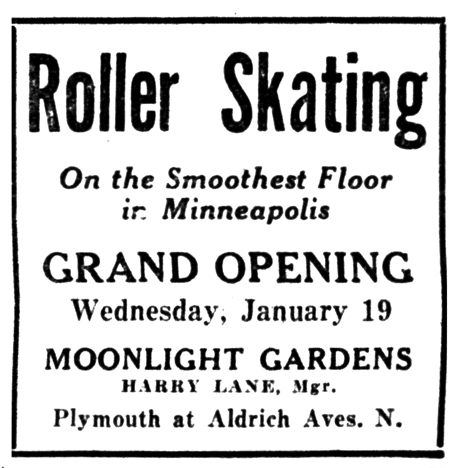
Minneapolis Tribune, January 18, 1927
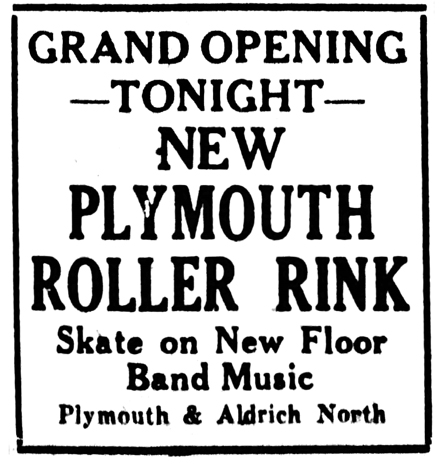
Minneapolis Tribune, September 24, 1927
CITIZENS’ PROTECTIVE LEAGUE
Dances must have stopped, because in April 1933, they started up again. 15 men who had been receiving unemployment assistance got together and fixed up the building and began to hold four dances each week in the building. Some of them played in the band and the rest worked on other chores. With the profits they helped the unemployed, especially truckers. They also collected clothes for families in need. (Minneapolis Star, April 4, 1933)
MOONLITE TAVERN
With the end of Prohibition in 1933, the Moonlight Gardens became the Moonlight (or Moonlite, as the ad says) Tavern. A New Year’s Eve WHOOPEE was planned for December 30, 1933, featuring four big floor shows with 37 Special Acts. “Dance to Jimmy Dunn and His Moonlight Stars Band into the Night. $1.00 per person, including noisemakers and New Years’ Breakfast.”
An ad showed that the owner sought to sell the building at the end of June 1934.
GAY PAREE
The Gay Paree was owned by Lester J. “Curlee” Elliott and Roy Olson. They owned it starting in about October 1934.
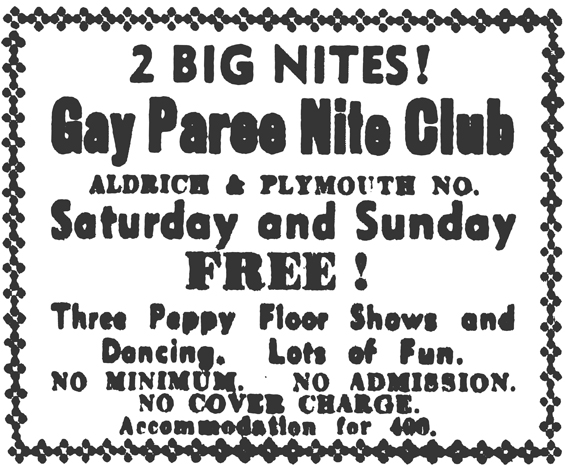
Minneapolis Tribune, November 24, 1934
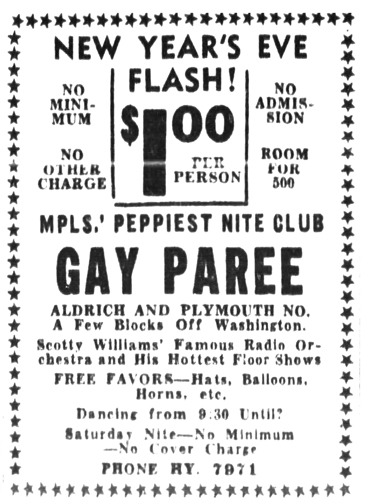
Minneapolis Tribune, December 29, 1934
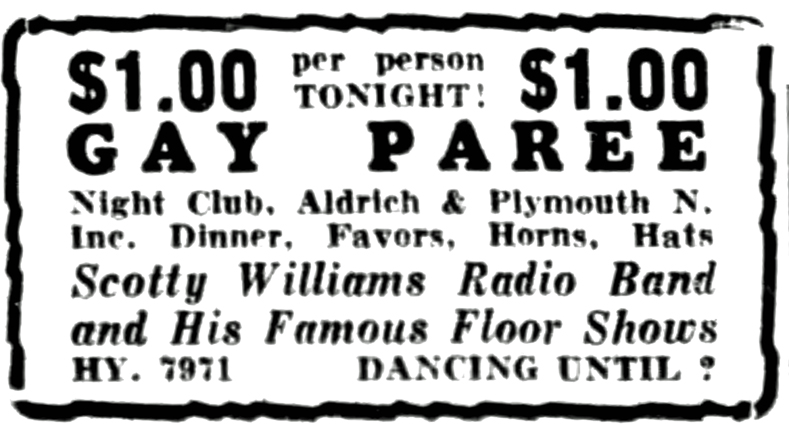
Minneapolis Star, December 31, 1934
On March 21, 1935, Curlee and Roy reported that “two masked, cursing bandits” invaded the night club and held up 15 employees, including members of the orchestra, coming away with $40 “loot.” Curlee had just left with the day’s receipts, and member’s of Frank Hines’ band saved their cash by dropping it on the floor. Roy got slapped for not moving fast enough.
Then it turns out that the whole robbery was a hoax, planned to be a cheap way to get publicity for the Gay Paree without paying for it. The police were not pleased, and neither was the judge: Curlee was sentenced to a $100 fine or 30 days in the workhouse for conspiracy to obstruct justice. Roy paid a fine of $25. And it looks like they lost their license as well.
MICKEY’S DINE AND DANCE
This barely merits a mention, since there was only one notice in the paper, looking for amateur performers in May 1935.
DANCING AND DRINKING DENIED
In August 1938, the City denied dance hall and tavern licenses to the place on the recommendation of the police. Another applicant, Albert Arbesfeld, was denied his request to transfer a 3.2 beer license from 2519 Plymouth Ave. to the place. No explanation was given, but it was inferred that the applicant was “fronting” for a well-known underworld character.
ROLLER SKATING CONTINUES
The name Rollaway Roller Rink appears just once, in March 1940. It’s unclear how long this activity lasted, but the building was advertised for sale in October 1940.
BANNER CANVAS CO.
The use of the building kind of disappears until August 4, 1966, when it was hit by a Molotov cocktail during the 1966 Northside riot. At that time it was the home of the Banner Canvas Co. The photo below gives us a hint of what the building looked like.
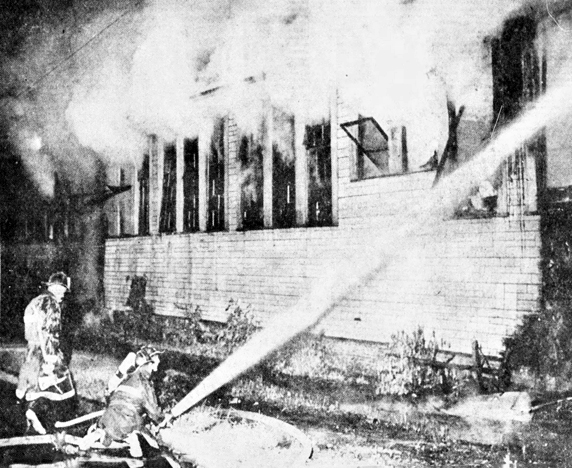
Minneapolis Star photo by Bob Schranck, August 4, 1966
DEMOLITION
The building was wrecked, probably because of fire damage, in March 1968.
This page has to do with the clubs that have taken residence at 5 So. Fifth Street. This is basically the basement of 507 Hennepin Ave., and part of what is known as the Hale Block.
Those clubs include:
- More Down Stairs
- Dave Rooney’s Downstairs
- Dirty Old Man
- Five Club
- Sand Box
- Cabaret
- Cellar Bar
- Blitz Bar
For more on the Loeb Arcade and the Hale Block, classic buildings that stood at Fifth and Hennepin, please click here.
ARCADE CAFETERIA
This ad seems to imply that the Arcade Cafeteria was located on the Fifth Street side of the Loeb Arcade, downstairs, so I’ll put it here. The ad promised “Music During Meals,” and in 1915 that most certainly means a live performer or band.
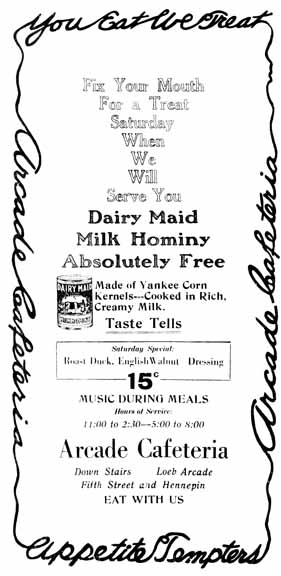
Minneapolis Tribune, December 11, 1915
CARTWRIGHT ORIGINALS
Will Jones reported that this “vast space had originally been occupied by Cartwright’s Originals dress showroom.” Cartwright’s Originals was a fancy dress shop, located here from about 1946. It was owned by Mr. Mandell Morgan, who died in 1974. When the storefront had to move when the Loeb Arcade was demolished in 1966, Cartwright’s Originals moved its showroom out of the basement.
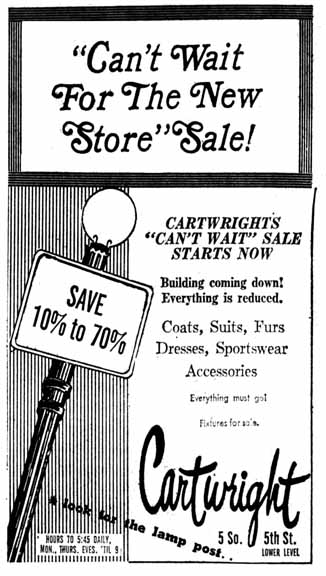
Minneapolis Tribune, October 24, 1966
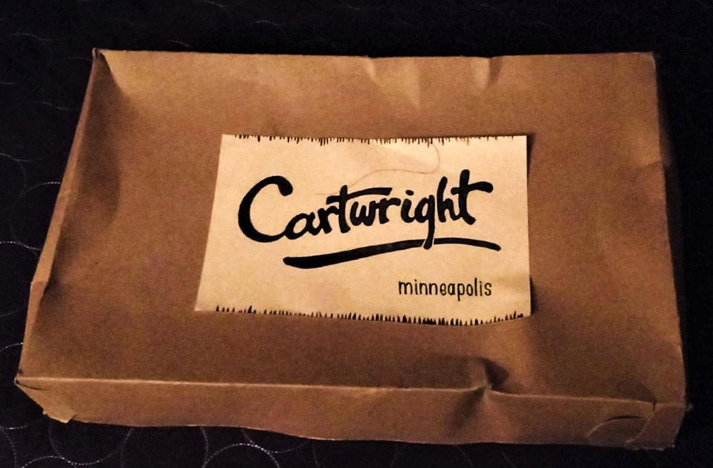
Cartwright Originals moved to 25 So. Fifth, but went out of business on February 1, 1976, when the bookkeeper was convicted of embezzling $200,000 from the business.
MORE DOWN STAIRS
More Down Stairs was opened by the owner of the Roaring Twenties, Big Al Cohen, on September 29, 1967. It a nightclub geared to the 21 to 35 crowd.
The space had a tier for watching and a tier for dancing, reported Jones. It was an honest-to-goodness bar as opposed to the teen clubs a lot of the bands had been playing.
It was the showcase for Danny’s Reasons in 1967 to 1968.
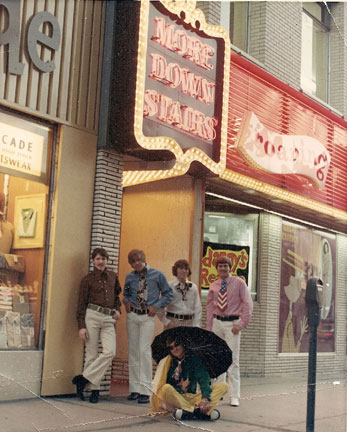
Danny’s Reason, from their website.
It then featured some of the top local groups, but they realized that once one band played, their following left and the next band’s fans came in.
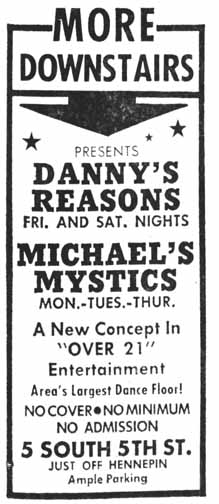
Minneapolis Star, October 6, 1967
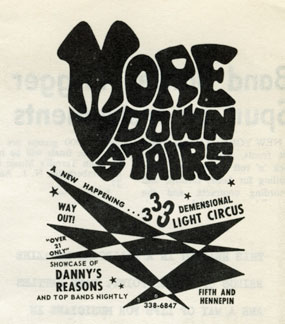
Ad from a 1968 Insider
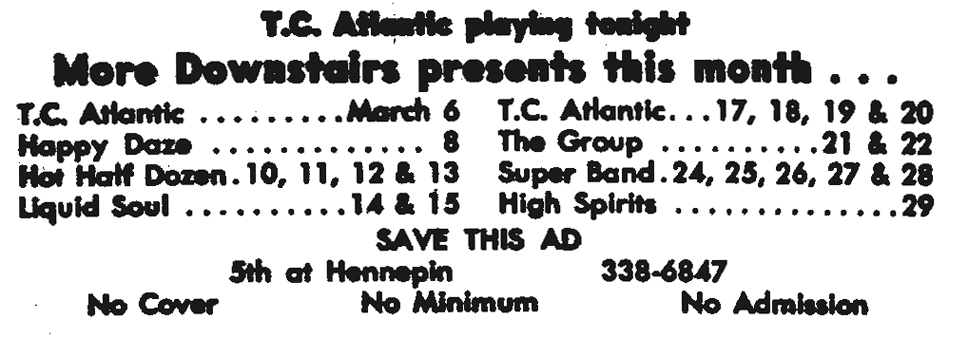
Minnesota Daily, March 6, 1969
To rectify this, they created a house band called Jumbo in July 1969, made up of musicians from several bands, intended to created a club clientele. They also reduced drink prices to 45 cents.
In September 1969, the club’s owners, Bobby Bell and Jerry Erickson, abandoned its rock format and hired the Bobby Crea jazz trio and exotic dancers. They kept the psychedelic lights. Ads for waitresses dropped off in about October 1969.
DAVE ROONEY’S DOWNSTAIRS
In December 1969, Dave Rooney bought the Roaring ’20s and the basement bar. On January 1, 1970, he opened Dave Rooney’s Downstairs in the basement space, as a showcase for his trio, which included Charles Gater on bass and Ron Lee on drums.
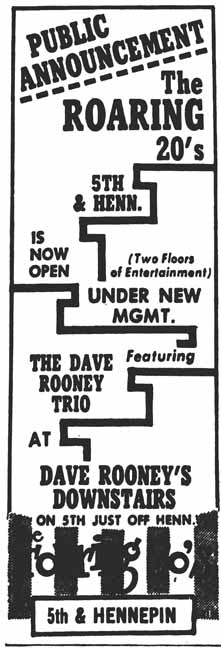
Minneapolis Star, January 1, 1970
Despite his remodeling of the place, his fans didn’t adjust to the Hennepin Ave. setting, however, and Rooney moved out in May 1970.
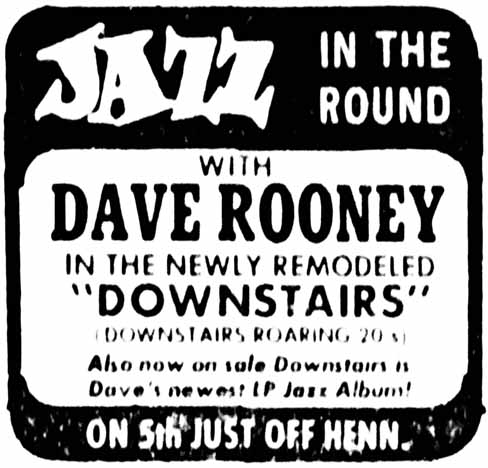
Minneapolis Star, March 12, 1970
DIRTY OLD MAN
I’m sure few will remember this short-lived iteration of the downstairs club, named for Arte Johnson’s Little Old Man skit he did with Ruth Buzzi on “Laugh In,” which was all the rage. The club opened September 10, 1970.
A hint to the theme was in Calvert’s ad for waitresses, who would be called “Downstairs Maids,” according to Will Jones.’
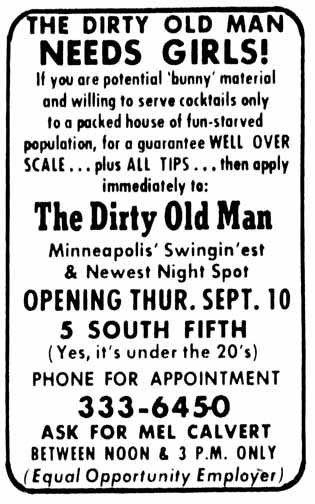
Minneapolis Star, September 8, 1970
There was also a Dirty Old Doorman, who was dressed like the Arte Johnson character, whose job it was to “stand out in front of the club and pinch girls as they come in,” explained Jones.
The club was opened by Mel Calvert, an entertainer who had recently had a long stint at the Black Angus. His act involved “songs and jokes and music on the Chamberlin electronic music machine,” per Don Morrison. Calvert had been out on the road for the last two years before opening this club.
Entertainment included the New Breed 70, a quartet led by Bob Hanson, who played a “competent and interesting jazz rock for dancing and earlobing,” according to Don Morrison.
Morrison described the room – “which used to look like the basement of a state hospital” – as “dressed up with a new bandstand and light panels that are geared with the mikes to change color according to volume and tone.”
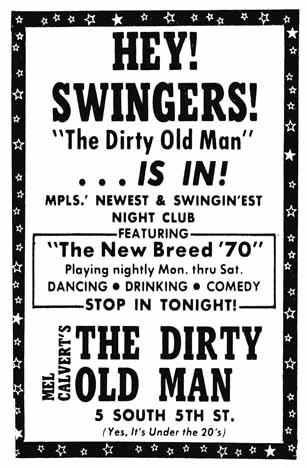
Minneapolis Star, October 10, 1970
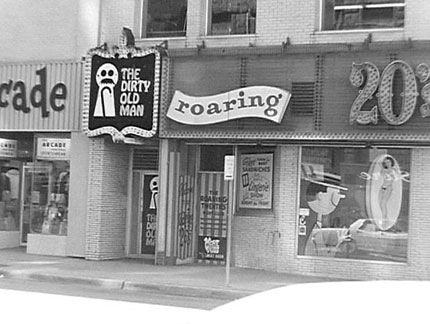
1971 photo courtesy the Minnesota Historical Society
An early booking was the comedian Professor Irwin Corey.
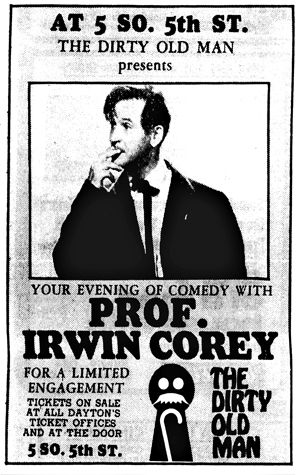
Minneapolis Tribune, October 25, 1970
In March 1971, Will Jones announced the Mel Calvert had closed the club and moved to Bradford’s, working as an entertainer. His article opened, “The Dirty Old Man took a bath.” (Minneapolis Tribune, March 18, 1971)
THE FIVE CLUB
According to the ad below, this club opened on May 10, 1971. The XL5, which had just come from a long run at the Cascade 9, were slated to operate the club as well as be the house band.
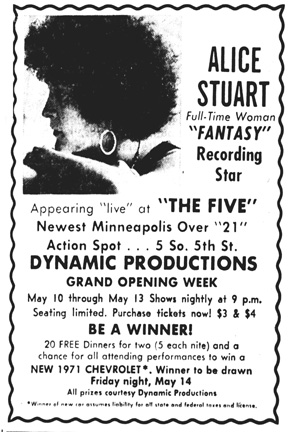
Minneapolis Star, May 6, 1971
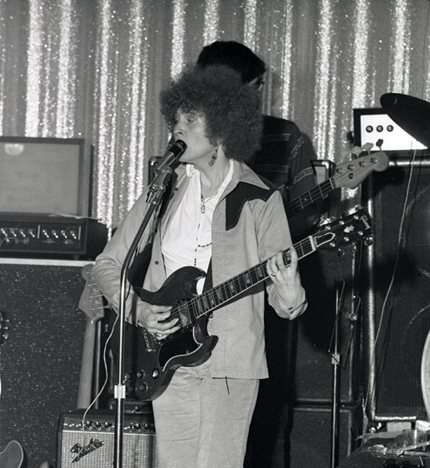
Alice Stuart at the Five, May 10, 1971. Photo copyright Mike Barich
THE XL5
The photos below are members of the XL5, taken at the Five Club on August 11, 1971.
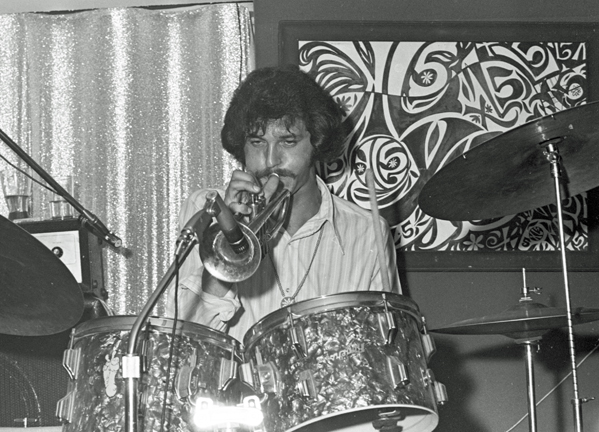
Photo copyright Mike Barich
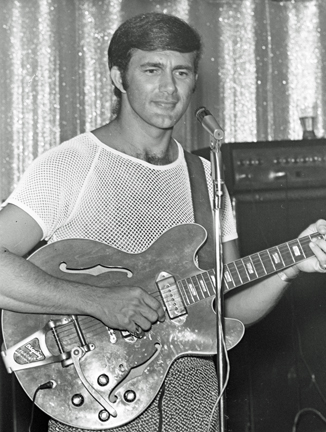
Photo copyright Mike Barich
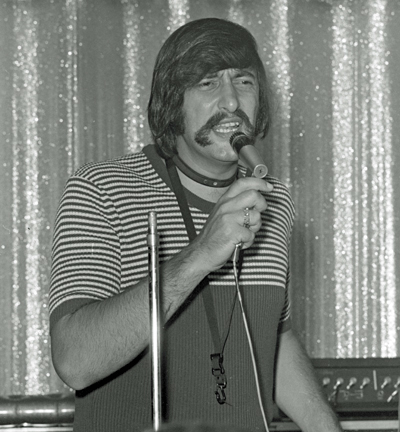
Photo copyright Mike Barich
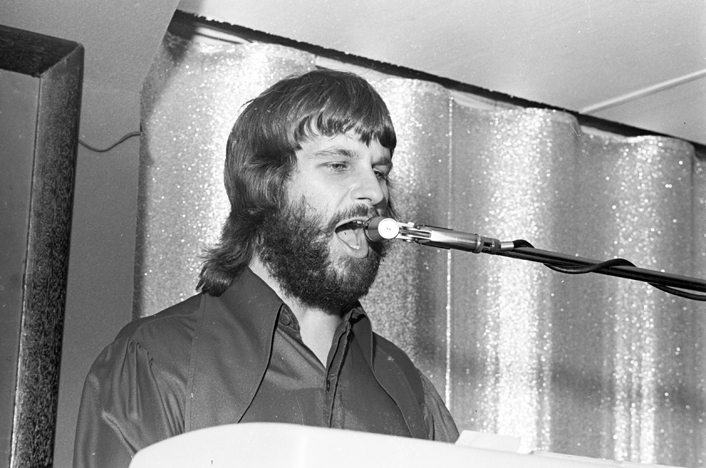
Gary Miernicki. Photo copyright Mike Barich
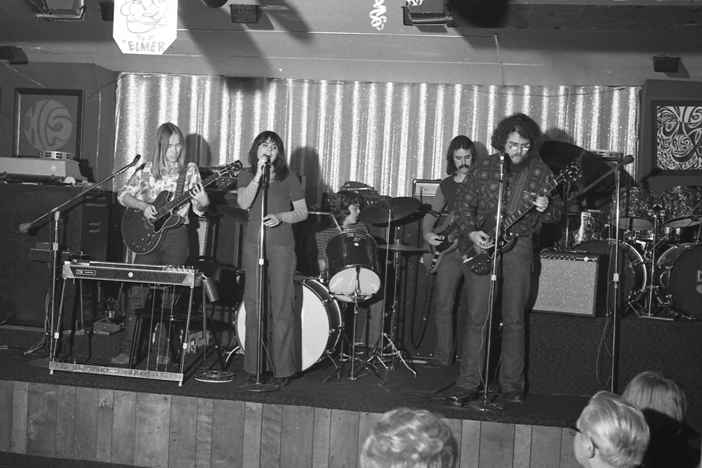
Linda Ronstadt at the Five Club, April 3, 1972. Photo copyright Mike Barich
THE SAND BOX
An even shorter-lived club appears to be the Sand Box, which can be found advertised for August 16 – 18, 1971 (Monday – Wednesday) only.
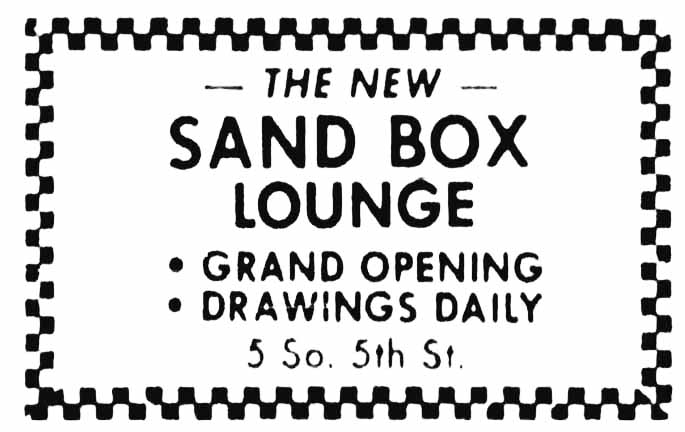
Minneapolis Tribune, August 16 & 19, 1971
CABARET SHOW LOUNGE
The Cabaret Show Lounge was a gay bar from at least December 1974 until mid-1975.
Facebook chat: “It specialized in female impersonators lip-syncing.”
MURDER AT THE CELLAR BAR
On January 4, 1975, the manager of the Roaring ’20s, Gerald T. Collins, was shot five times in the men’s room of what was identified in the papers as the Cellar Bar (downstairs). His killer, Royal K. Hayes, Jr., was a “cavalier psychopath” who had escaped in August 1963 from an Oregon state hospital he had been committed to after killing a security guard in 1962. He came to Minneapolis and immediately got caught robbing a Walgreens at 828 Nicollet. He was sentenced to 20 years at Stillwater State Prison in 1963, but was paroled in 1968.
Collins was shot with Hayes’s gun, but attorney Ron Meshbesher cast enough reasonable doubt that Hayes was acquitted. Later Hayes would brag about how he beat the rap. Hayes did do a year for possessing the gun that killed Collins.
But things got grisly when Hayes was found guilty of shooting and mutilating the bodies of two drug dealers at the University of California at Santa Cruz in December 1981. He was sentenced to death but with the reversal of the death penalty in California, remains on death row indefinitely. If he is still alive (I found no death information on Ancestry.com) he would be 83 in 2020.
Collins himself was no angel – he’d gone to prison for burglary in 1950, and got five years in 1953 for hitting a policeman with a ball peen hammer when he was caught robbing a bar. On March 1, 1963, he robbed the Nic-O-Lake Super Valu and he and his partner were found 10 minutes later in his mother’s car. Cops noticed they were nervous and looking around, so they searched the car and found a gun and $12,000.
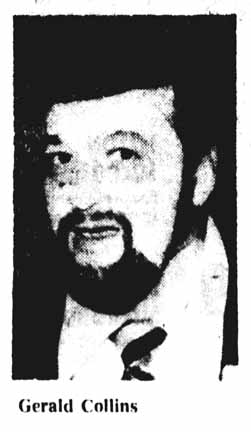
Minneapolis Tribune, January 9, 1975
Out on bond, he robbed a used car lot on E. Hennepin in August 1963, and a grocery store in Coon Rapids and a deli on E. Hennepin in November 1963. In February 1964, still out on bond, he robbed Erick’s Bar. While the Super Valu trial dragged on with appeals and mistrials, he was sentenced to ten years for the Erick’s Bar caper.
Once in Stillwater for the Erick’s job, he became an informer for the government, putting former partners in crime in jail. Some were not impressed. When testifying on behalf of a criminal, pleading to Judge Miles Lord to give his friend probation, Lord called Collins a “tough, mean burglar” and said that he had been a “bad boy from the time he was 9 years old, a mean, rough kid.” (Minneapolis Star, September 6, 1974) Still, the man was given probation. Finally, Collins was sentenced for the Super Valu job, given only five years, concurrent with the ten years he was already serving. He was released in 1968.
Whether he actually went straight or not was up for speculation, even after Collins died at the age of 42. As for the motive of the murder, it may have never been determined. He had alienated good guys and bad guys alike. Or maybe Hayes was just crazy.
BLITZ BAR
April 1976 – 1977
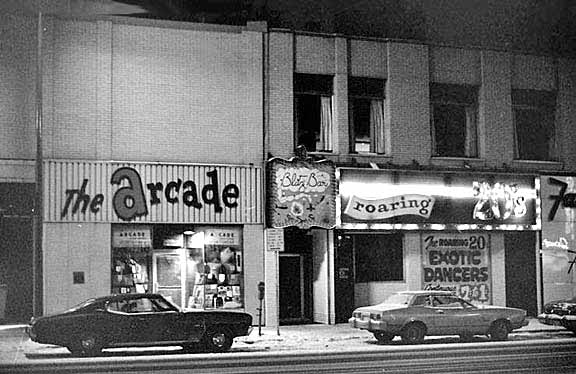
1977 photo courtesy of Minnesota Historical Society
The Arcade clothing store next door is a nod to the old Loeb Arcade Building.
A demolition permit was approved for the New Hale Building on March 13, 1986.
In the first issue of the Minneapolis Spokesman, the “Amateur Man about Two Towns” told readers: “Mother Carver’s place on the Sixth Avenue North Road is still the gathering place for those in the know. Frank Hines tickles the ivories at the nite spot, and Tommy Lewis croons as only Tommy can.”
Mousey’s Bar was not really a music venue, but please see the Ramona Cafe for its interesting history.
Mr. Goldfinger’s was located at 4107 W. Broadway in Robbinsdale.
This was previously Hoagie’s Choice Foods, owned by John Flaherty, who had owned Someplace Else. It opened in about February 1967.
Occasionally the restaurant featured jazz acts such as Bobby Williams. At one point Ramsey Lewis came and played for free.
Flaherty sold it after a year.
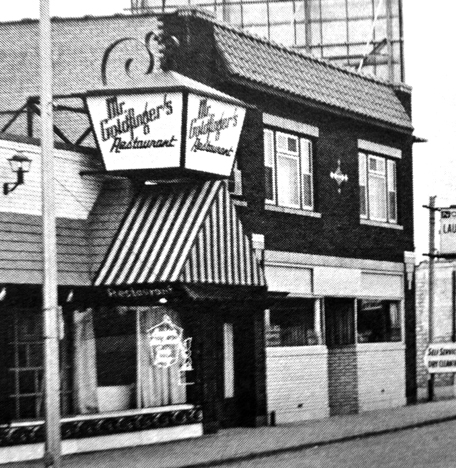
Photo courtesy Pete Richie, Robbinsdale Historical Society
Mr. Harry’s Liquor Lounge, also known as Mr. Harry’s or Harry’s Bar, was located at 229 W. Broadway at Washington Ave. in Minneapolis.
229 W. BROADWAY
The building goes back to 1885, when it was built with three stories with an address of 227-229 W. Broadway. In the usual style, people lived in apartments in the stories above, and there were storefronts on the ground floor. 227 W. Broadway appears to have been a barber shop for a very long time.
In 1890 the building hosted a saloon, according to permit records
In 1929 it was a radio store.
In 1932 it was Pliam Linoleum.
In 1934 it was a cafe.
In 1937 it was a “beer parlor,” possibly Rudy’s Place.
In October 1949, the top two stories were removed. I could not find a reason.
BOFFERDING’S BAR
In 1950/1951, it was either the Bofferding and Cronkhite Bar, or the Crohkhite and Bofferding Bar. Jacob (Jake) Bofferding and E.J. Cronk(h)ite – papers weren’t too reliable on spelling in those days. Jake Bofferding had been a grocer at 329 Plymouth Ave. on the North Side since 1916.
By January 1957 it was just Bofferding’s Bar. A fire damaged the building – called a North Minneapolis Landmark – on January 19, 1957.
In January 1961, Edward C. Bofferding died at the age of 47. He was identified as the owner of Bofferding’s Bar.
In 1967 the bar underwent a major rehabilitation, adding air conditioning. Excess bar equipment was advertised for sale.
MR. HARRY’S LIQUOR LOUNGE
Harry Skrypec took over the bar in about May 1969, advertising for bartenders: “must not drink.” George Kottes was the manager.
In January 1971 we know the place had music, or at least used to – robbers broke in and tied Mr. Harry, Kottes, and a third person to the bandstand and stole a bunch of money.
Another renovation appears to have gone on in August 1971, with an ad for equipment for sale.
The last ad for bartenders for Mr. Harry’s was dated July 10, 1980.
BJ’s LIQUOR LOUNGE
Jerry Bjurstrom opened BJ’s Liquor Lounge in 1980. BJ’s was a neighborhood bar like any other, with one added feature: topless dancers. Behind the bar, topless women with beatific smiles gyrate on a stage. With no cover and standard $20 lap dances performed out in the open, what you see is what you get at BJ’s. There are no hidden rooms with off-menu services, and strippers walk with 100 percent of their tips. This strip club/dive bar knows not to meddle with a good formula, and that’s why its clientele is almost entirely composed of regulars. When it opened, the city had not yet passed its strict adult entertainment zoning laws, which now confine such activities to a few parcels of land downtown. In February 2018, Jerry Bjurstrom died. His son Brian Bjurstrom inherited the business.
The City put a 2020 deadline on stripping at the club, and the last day was December 23, 2019. A developer was in negotiations to purchase the building and the other property that Bjurstrom owned in the vicinity. As of December 2020, no indication of changing hands is seen on the Hennepin County database since 2003.
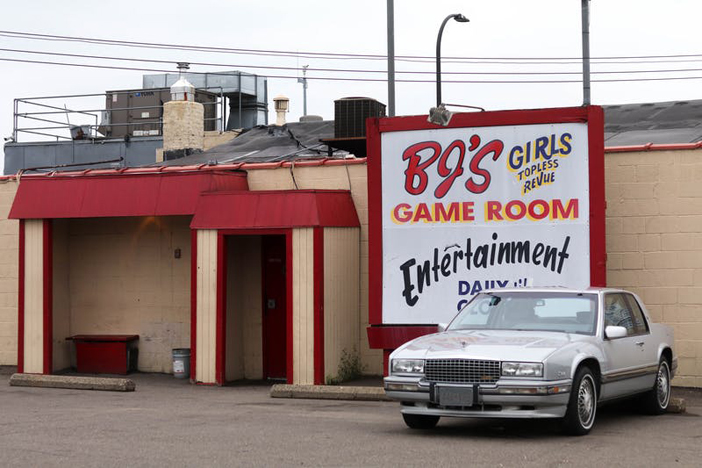
City Pages, June 27, 2018
Mr. Joe’s was located at 1964 W. University Ave. at Prior in St. Paul, in the Midway Motor Lodge.
The 100-unit Midway Motor Lodge opened on June 2, 1960. The lodge offered an indoor heated swimming pool that kids (often successfully) tried to sneak into. The owners were Robert Gisselbeck of Minneapolis, Edward O. Luedke of Milwaukee, and James Hammert of St. Lauderdale. The dining room and cocktail lounge were leased to Joe Kozlak, one of the owners of the Jax Cafe.
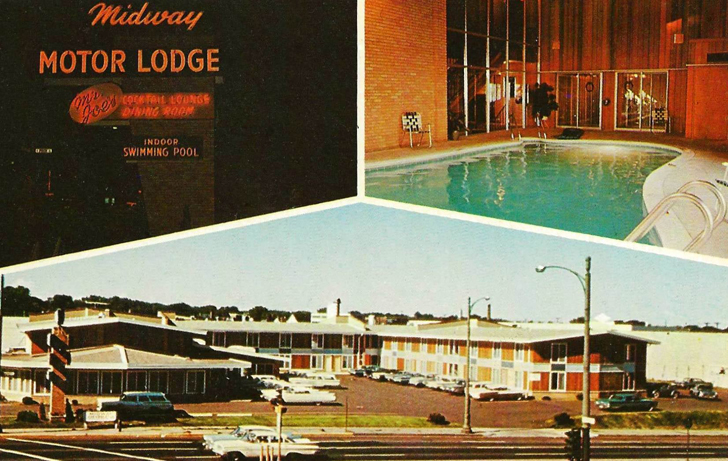
Postcard from 1957
Quoting James Lileks:
Mr. Joe’s was a supper club at the old Midway Motor Lodge. The Midway was across from the Twins, another motel – sorry, motor lodge. For some reason the presence of two huge motels at the same intersection gave the corner some importance and permanence. The Twins was demolished a few years ago, the space turned into an enormous hardware store. The Midway survives. It’s been remodeled from its original appearance, of course; who wants classic 60s motel styling when you can have late-80s / early 90s oversized cartoony Mansard roofs besides EVERYONE WITH A SENSE OF STYLE Sorry, didn’t meant to shout.
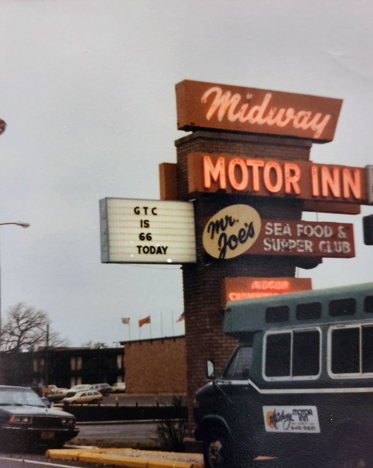
A 16-year-old girl drowned in the pool while at a pool party in August 1967. Another boy drowned in 1979.
In July 1968, the ad said Mr. Joe’s was under new management.
In 1974, the Trustee for Twins Midway Motels, sought to end the lease with New World Inns to operate the Midway Motor Lodge and the Twins Motor Inn.
In 1979, food critic Karin Winegar of the Star took a trip to Mr. Joe’s and came out calling it the “Best Bargain Around.” After whining about the lack of seafood in the Twin Cities, she admits,
… but the dim, old-fashioned red and black dining room still offers a nice selection of marine life served in field-hand portions with hot popovers and a large salad bar.” She calls the dining room quiet, and in this pre-nonsmoking world, she warns that “requests for a non-smoking section at Mr. Joe’s are ignored.” (Minneapolis Star, March 30, 1979)
In one ad in 1981, the “Midway Twins Motor Inn” has the address 1964-1965 University Ave.
In January 1985, the papers published that the hotel was behind in its taxes.
The Motel began selling off its furniture on January 4, 1986.
It came back to life as Midway Lodge in January 1988. On July 18, 1988, Carlos Caprice, head of the St. Paul gang the Disciples, was found dead in one of the rooms of the motel. The cause of death was determined to be an overdose of cocaine. (Minneapolis Tribune, August 18, 1988)
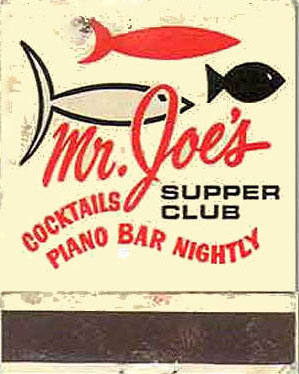
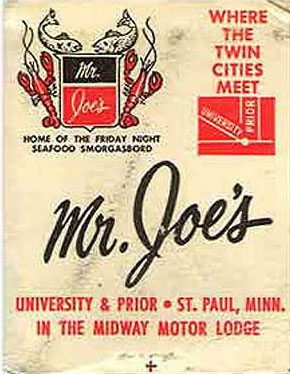
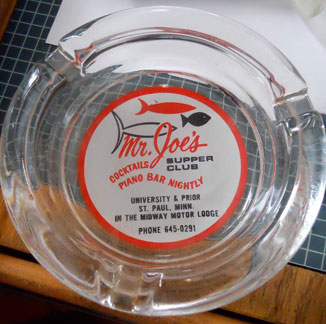
Ashtray from the collection of Mark Youngblood
MUSIC AT MR. JOE’S
Almost every ad (and there were few, except for holidays, until 1969) focused on the food at Mr. Joe’s, with music at the piano bar as a small added attraction. Different people tickled the ivories during the late sixties and seventies, but one name is fairly consistent, and that is Bruno. In 1968 it was “Tiny and Bruno.” Who or what is Bruno? Here’s one of a series of ads from that era – can you pick out the entertainers?
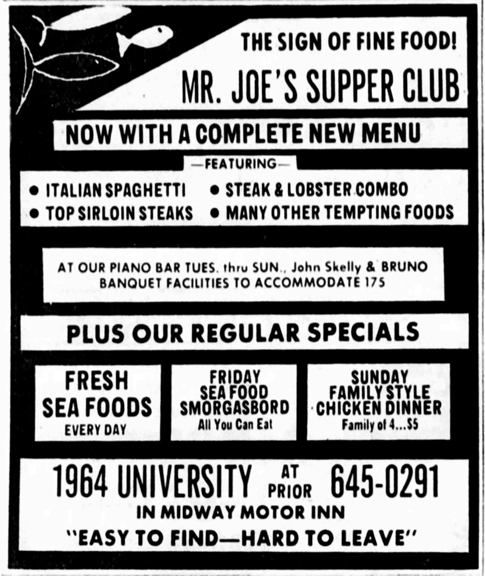
Minneapolis Star, July 10, 1969
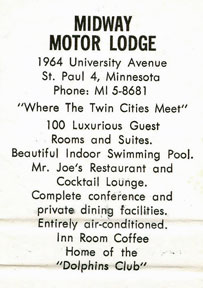
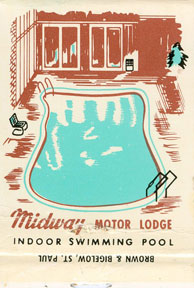
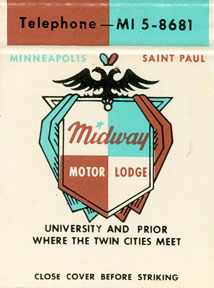
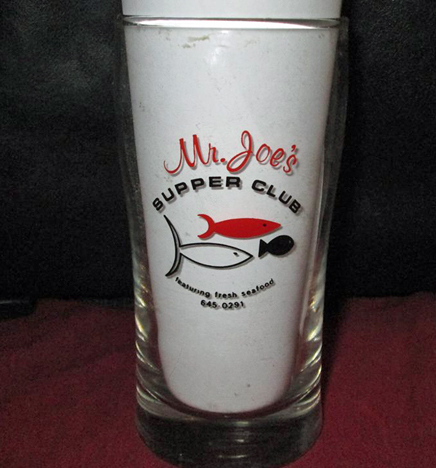
Image courtesy Tom Wehler
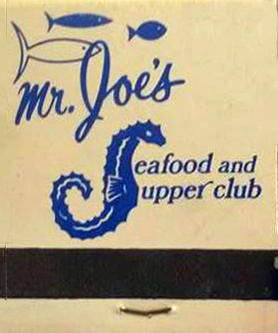
Image courtesy Kimberlee Duran
DAYS INN
At some point before 2006, the Midway became a Days Inn.
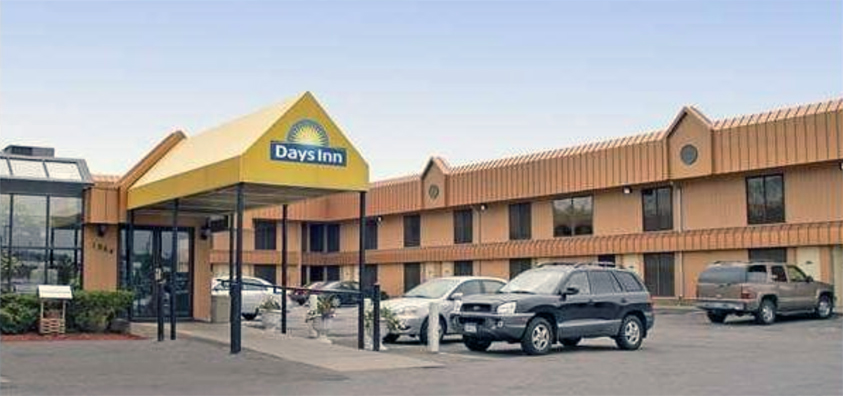
Days Inn by Wyndham St. Paul-Minneapolis-Midway, to be exact.
And Mr. Joe’s was gone. At this writing it is a burger joint called the Midway Cafe and Grill.
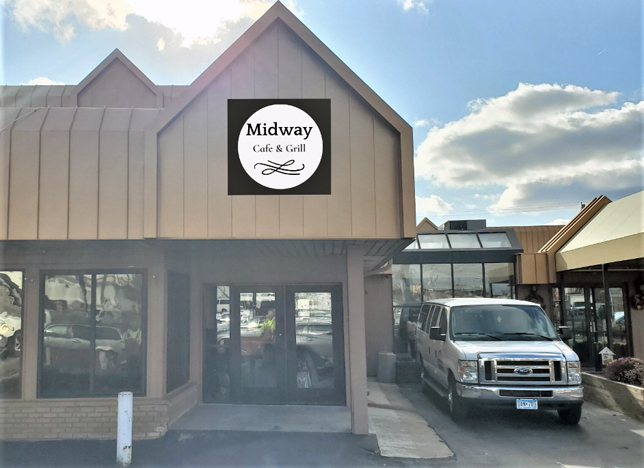
All ads on this page are from the Star Tribune unless otherwise noted. Additions, corrections, and stories are appreciated; please contact me.
This building at 2933-35 Nicollet Ave. at Lake Street was a lively spot for decades. But don’t go looking for it or you’ll find yourself inside the K-Mart where Nicollet Ave. used to be. Here’s an old map, marked where I think it was:
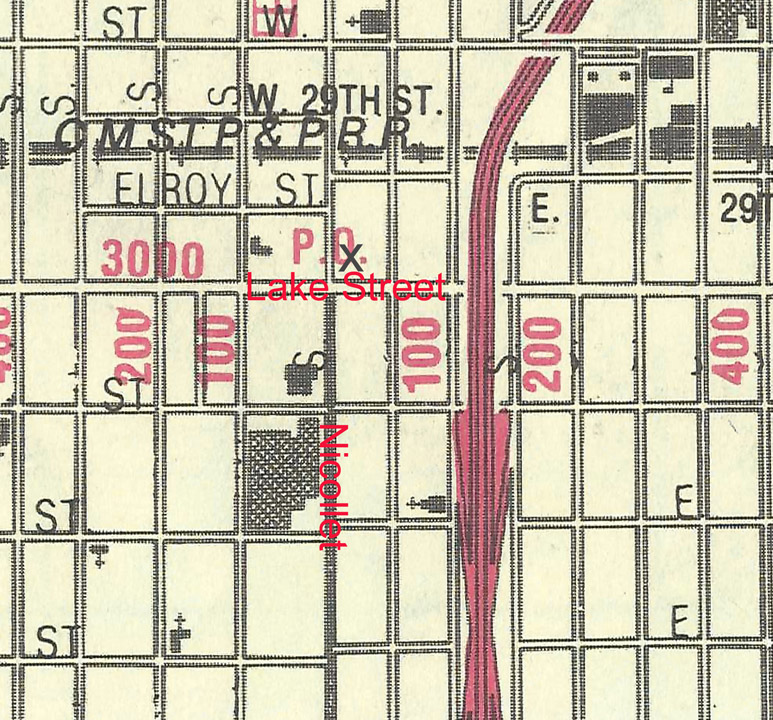
The space was often subdivided in ways that are a little mysterious, but I’ll do the best I can to reconstruct the different, wonderful places and activities that took place here.
HOTEL AND STORE
The site’s earliest history can be found in the permits and inspections records at Hennepin County Library Special Collections. In March 1886 a permit was taken out to build a wooden structure to be used as a store and hotel. Listings for the hotel continued until 1892. An ad to rent “a very pleasant suite of two rooms on second floor” and a “barn for storage or auto space” at this address appears in 1910.
SCHULSTOCK SHEET METAL
A permit for an iron electric sign was taken out in March 1917, no doubt for this business.
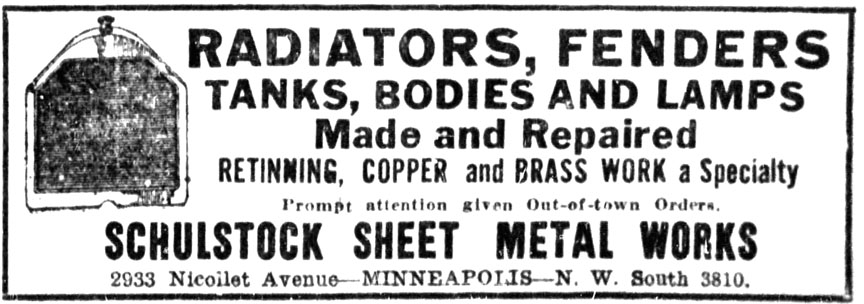
March 11, 1917
Nevertheless, a permit to demolish the barn was taken out in July 1917 and two dwellings in May and September 1918.
DAY-NITE GARAGE
In April 1919, a building permit was pulled to build a brick and concrete private garage measuring 140 ft. by 123 ft. Cost was estimated at $15,000. By garage this meant a car dealership. In 1923 the owners requested permission to install a gas pump.
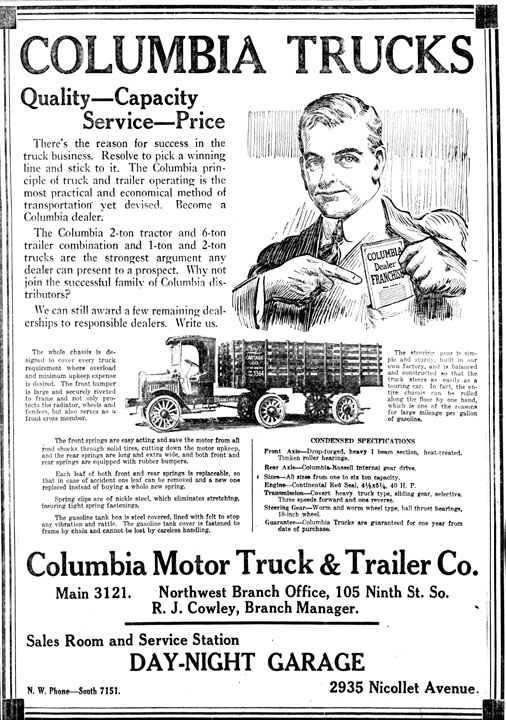
August 31, 1919
In September 1924 a permit to build an 18 ft. by 56 ft. addition was pulled. In 1925 Day-Nite Garage and the filling station were owned by R.J. Johnson.
INDOOR GOLF COURSE
In September 1930 John A. Nelson received a permit to run an indoor golf course. Permits to do the necessary electrical and plumbing work and to erect a sign were pulled in October. This was probably only there a short time – found only two mentions in the Strib.
Not to be confused with the 18-hole Tender Trap, a Mini-Golf place listed at 29th and Nicollet, next to Magoo’s. References to this place appear from December 1966 to November 1967.
TRIANON DANCE HALL
The first of several dance halls was conceived in December 1931 when Melville J. Nelson applied for a permit for dance hall. Another notice says that Mrs. Nellie C. Little installed new floors and replaced the roof on the building at a cost of about $3,000. This turned out to be Minneapolis’s own Trianon Dance Hall!
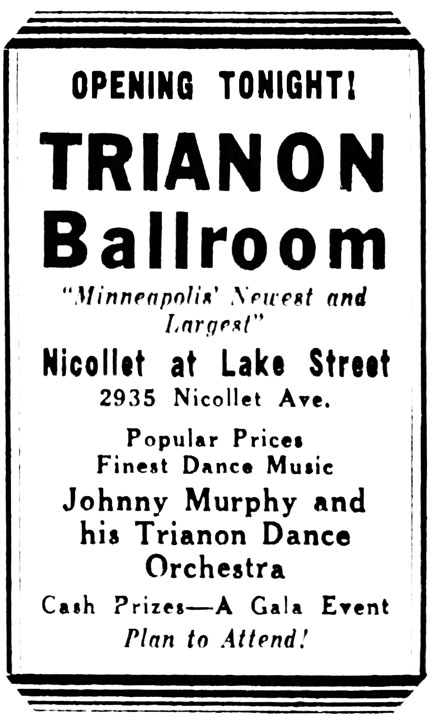
December 30, 1931
The only other ads for the Trianon found were dated March 19 and an Opening Dance on August 27, 1932. It may be that it was closed during the summer months – before air conditioning, ballrooms were simply too hot. That August the holder of the dance hall license was Ernest G. Bjorklund.
DANCELAND
Further alterations and repairs were done in the spring of 1933. Plumbing for a cafe was added that June. A liquor license (probably for early post-Prohibition beer) was obtained in May 1933. A new iteration called Danceland opened on December 9, 1933, featuring the music of national sensation Cab Calloway. Oh wait! That’s Cal Callaway! More electric work for the dance hall and a new iron electric sign were added in January and February 1934.
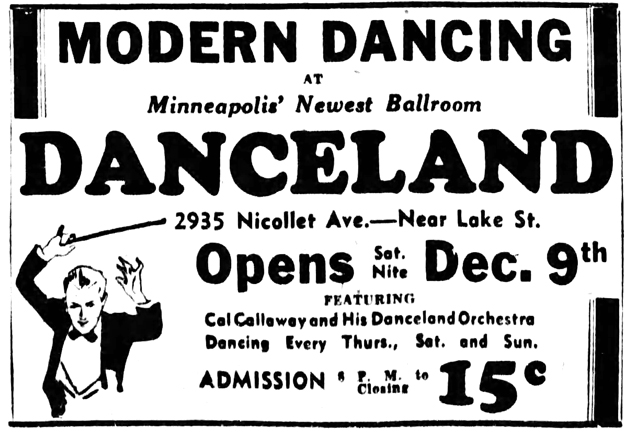
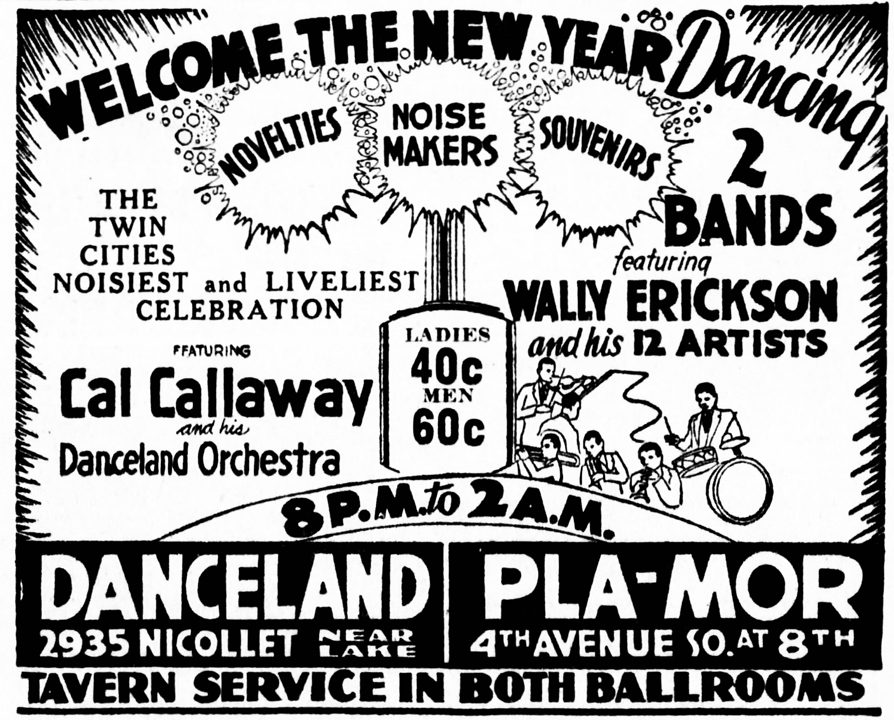
December 31, 1933
Unfortunately, Danceland, which was apparently still owned by the Trianon people, did not succeed. On May 12, 1935, an ad appeared:
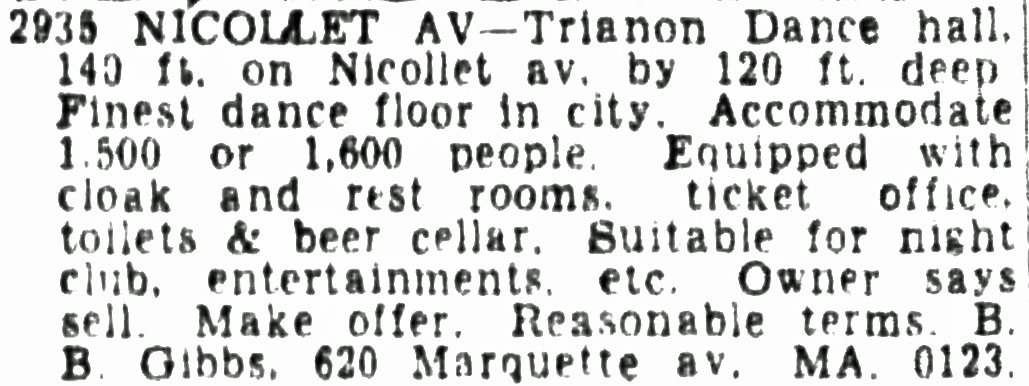
FRIENDSHIP CLUB
The Friendship Club was the brainchild of Frank “Smilin’ Bob” Kenney and his wife Kathryn. Kenney was originally from St. James, Minnesota, and had served in WW I. In 1931 [1929] he was a night club waiter in Milwaukee and figured that there were lots of people who couldn’t afford a $3, $4, or $6 evening, but would still like to have a place to dance at a reasonable price. He also felt for lonely people who had nobody to dance with or felt that they were too old to dance with the youngsters. He invited a group to his mother’s house to dance, and as it grew it moved to a hall. First called the Lonesome Club, it later changed to the Friendship Club.
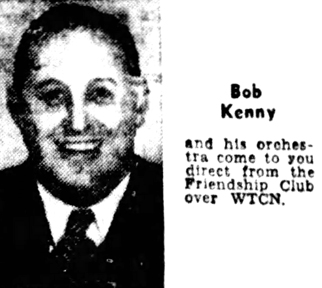
July 11, 1936
Bob brought the idea to Minneapolis in 1935; wife Kathryn stayed behind for a year in Milwaukee. Kenney’s orchestra presided over the immense dance floor starting in October 1935. Kenney had a huge collection of arrangements stored in a special closet. The Friendship Club apparently occupied the entire building from 1935 to 1952.
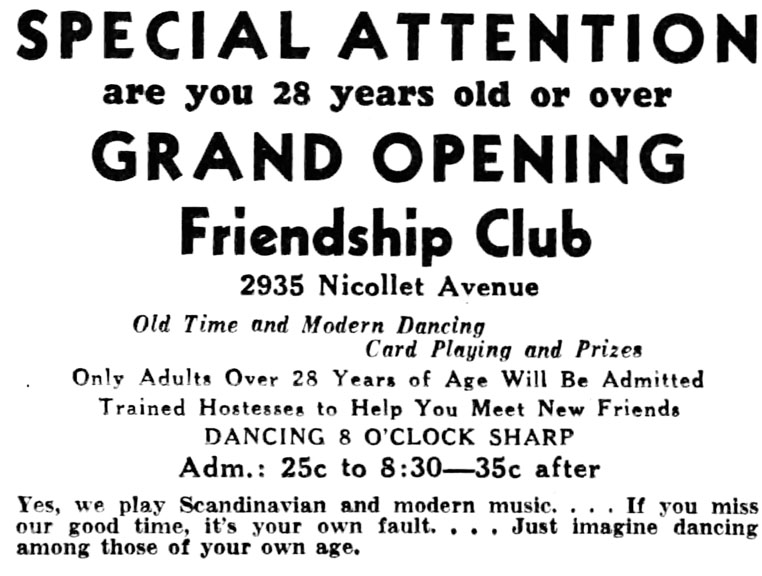
October 11, 1935
There were lots of rules at the Friendship Club:
- The Club was only open to people over 28 – the unusual number came about because women didn’t want to admit they were over 30!
- No liquor was allowed – anyone caught nipping was given the boot. (3.2 beer was available)
- No cutting in
- No jitterbugging (a sign said “Positively No Fancy Dancing”)
- Applicants had to have references and be voted in by a committee.
- “Positively No Two Ladies Dancing Together During Get Acquainted Dances”
- Men must wear ties.
- No tables reserved
Its “Get Acquainted” dances were described by Cedric Adams:
There are two of them during the evening. The dance lasts for about 20 minutes, and starts out with a march which is followed by a waltz, a circle two-step and a Paul Jones. You start out with your own partner, Bob blows a whistle. That means all dancing stops for a second or two. The couples promenade in twos, fours, or sixes and then girls step back one partner. The new partners greet each other, shake hands, make themselves acquainted, and the dancing is resumed.
Kenney’s orchestra and booming voice were broadcast over a variety of radio stations for many years. The club was open Thursdays, Saturdays and Sundays.
An overhaul at the dance hall came in May 1936.
1937
A Junior Friendship Club was announced in January 1937. The ad was quite wordy, and typically full of rules:
Every Friday night The Friendship Club sponsors a party for all the young people who will conduct themselves as ladies and gentlemen while at the club. Positively no liquor allowed, just good clean fun. Remember if you’re stuck up and not a good mixer, stay at home. We only want those who will join our get acquainted dances and dance with everybody. It’s just loads of fun. Membership cards free to anyone who is a good mixer; so check your conceit outside and be a good scout. Make every Friday nite your club nite, a party where Mother and Dad will be pleased to let you go. Music by Smiling Bob Kenney and his Troupe of entertainers playing both old tyme and modern music. Featuring The Television Queen, Amanda Snow, Friendly Voice of the Air, Mel Burlingame and that funny comedian, Moxie Ryan. Broadcasting WMIN 8:15 PM Tues., Thurs., Sat. and Sun. Are you coming, are you regular? Admission 25c until 8:30 35c to closing.
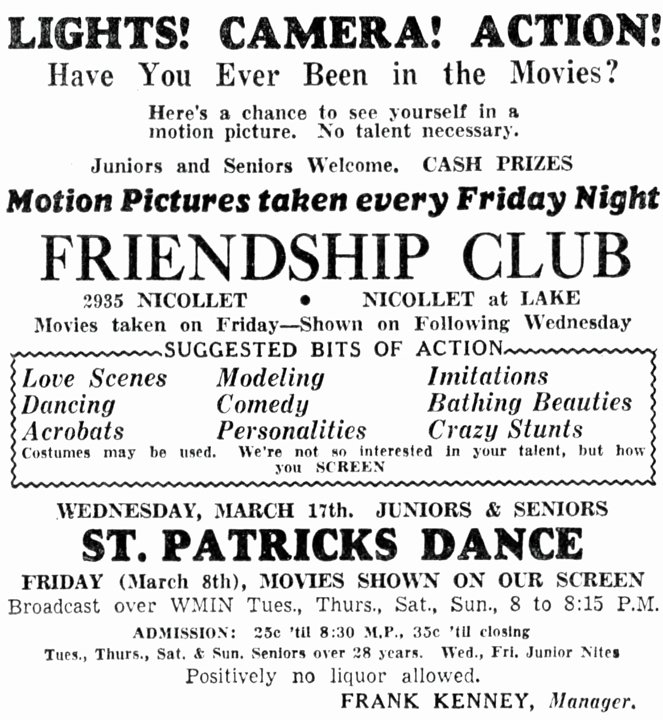
Not sure what this was all about! March 17, 1937
June through October 1937 saw a great deal of work done on the dance hall and cafe; this was when air conditioning was added. The ad for July 3, characterized as a Homecoming for Smiling Bob and his Orchestra, is hilarious:
All air-conditioned and redecorated. Cool! Boy, oh boy it is swell! The garden spot of Minneapolis. Don’t be Fooled, when your friends say it is hot, let’s go to the lake. The big mosquitoes will bite you if you don’t watch out. No mosquitoes at the Friendship Club and it is cool as a cucumber.
1939
On October 22, 1939, Cedric Adams did a full-page article on the Friendship in the Star Journal. By 1939 membership was up to 8,000.
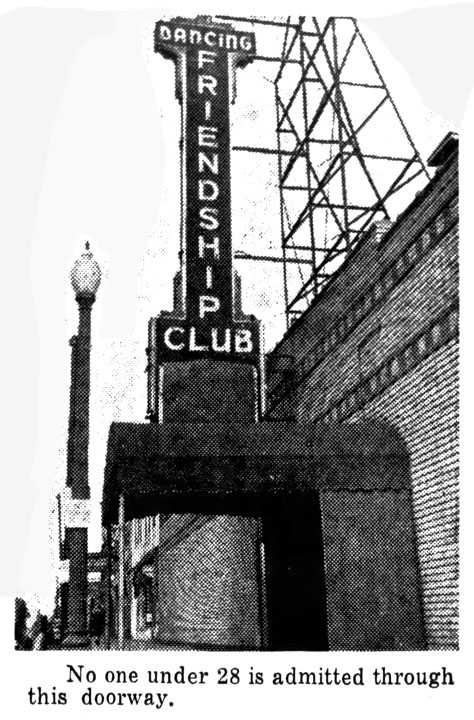
October 10, 1939
1940
In May 1940, Cedric Adams reported that the Friendship Club merited a front-page story in Variety: “Big Coin in Lonely Hearts.” Stories were also being contemplated for Life and Time magazines. Membership was up to 9,000.
1944
Frank S. “Smilin’ Bob” Kenney, the founder of the Friendship Club, died of a heart attack in January 1944 at the age of 51. At the time of his death he was the secretary of the Nicollet-Lake Business Men’s Association.
1946
In April 1946 we learn from Will Jones that Frank Kinney’s widow has remarried and is now Mrs. William Brecheisen, still running the Friendship Club. She said, “We have tried clever vaudeville entertainment and novelty acts, but our customers don’t want that. They just want to dance and get acquainted.”
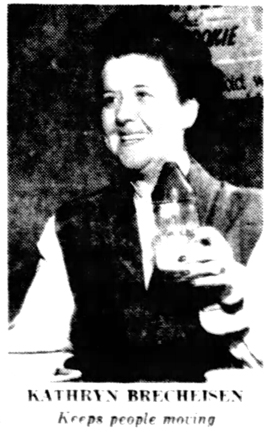
Mrs. B, 1951
Jones:
The man fearing mayhem at the hands of jitterbugs finds dance acrobatics banned at the Friendship; hostesses find even taller partners for tall girls.
And – this is the specialty of the house – oldsters who might be termed “corny” by the ordinary dancehall clientele are encouraged to ply the steps of 20 years ago.
1951
By 1951 membership had grown to 10,000. Another Will Jones feature revealed that the place was monitored by two policemen and three other security officers. The dancehall was recommended to traveling salesmen by hotel personnel. It was open Thursdays, Saturdays, and Sundays. “Mrs. B” was a “plump redhead.” Thanks, Will!
A February 1953 ad mentions cash awards.
In 1959, Fridays were contest nights. And you could vote for the King and Queen of 1959.
1960
Now you can’t say that the Friendship Club didn’t keep up with the times. In 1960 Jerry Mayeron’s orchestra infiltrated the Friendship Club on Sunday and Thursday nights, playing the newly-popular Latin rhythms on Sundays and “a standard variety of dance music” on Thursdays. The regular band continued on Saturdays. Looks like the age limit went down, too.
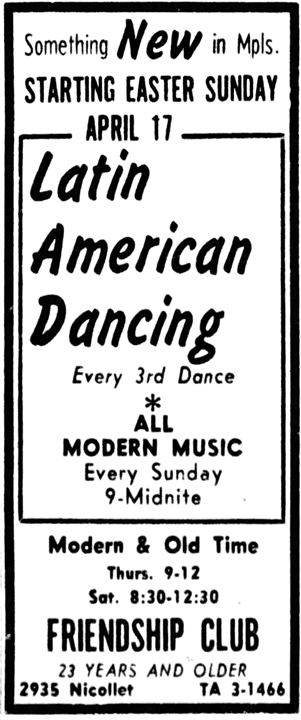
Mayeron was replaced by the Tail Gate Six in May and June 1960 – no clues as to what they played. Dick Kast followed.
1961
THE NEW FRIENDSHIP CLUB: 1961
Times were changing, and so was the venerable Friendship Club. Or maybe all the old patrons had married each other. Or died. Anyway, the owners saw a need to appeal to a younger, livelier audience. In January 1961 the venue was recast as the NEW Friendship Club, and Friday nights were designated as teen nights. The concept of teenagers was kind of new then – before that, there were adults, young adults, and children.
After some generic “Teen Dance” ads, the first to name a band was on February 10, 1961, when the reliable, rockin’ Mike Waggoner and the Bops held forth at the FC.
April 7: Garry Miles and the Casuals. Miles was one of four, count ’em, four artists who charted with “Look For a Star” in 1960. One of the others was one Gary Mills. Hmmm.
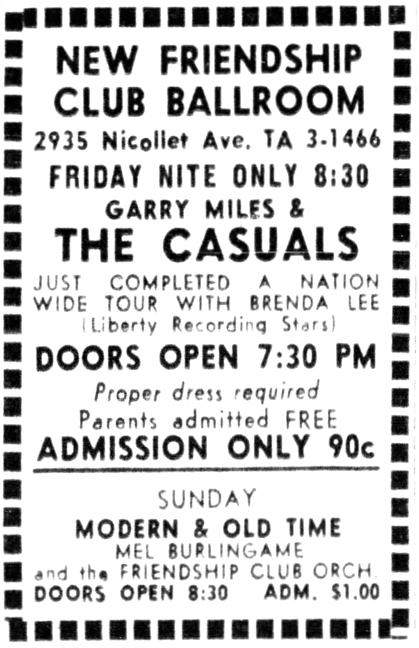
April 8: The Tradewinds. In an apparent new policy of trying to be all things to all dancers, the New FC hired a calypso/folk group to alternate with the old time dances and teen brawls.
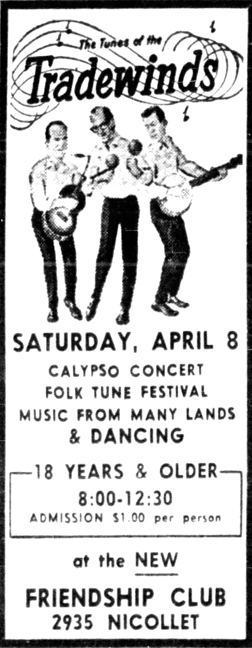
April 14: Johnny and the Hurricanes
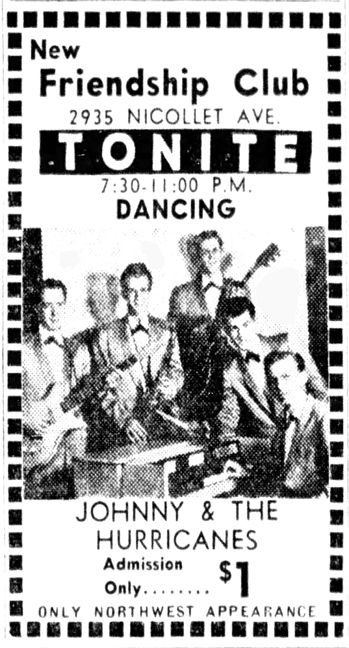
April 16: Doc Evans (Dixieland)
And that was the end of the Friendship Club. It had a good run.
THE LOON CLUB
In April 1961 the Friendship Club, which had drastically changed its format, morphed into the Loon Club. Will Jones noted, “The new owners there rushed to be the first to name a tavern after the state bird. All the signs proclaiming the myriad rules of the Friendship Club have been taken down, and the place is being redecorated gradually.”
1961
April 26, 1961: The first advertised group was the Tradewinds, a Calypso trio that had performed at the New Friendship Club. Even the ad was the same except that it had the new Loon logo. Doc Evans worked on Sundays.
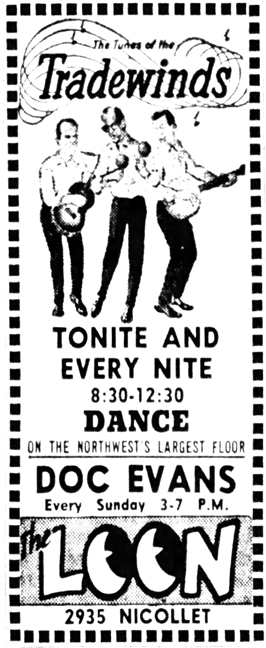
June 1961: Will Jones reported that Augie Garcia had “abandoned Lake Minnetonka” and was at he Loon Club Tuesdays through Sundays, with long sessions on Sunday afternoons.
Jones also reported:
The place strives to live up to its new outdoorsy name with some outdoor atmosphere. The management has imported 10 large live trees, and also has scattered 300 pounds of green sweepings on the floor to give a grassy effect.
October 17 – 23, 1961: Jerry Wallace
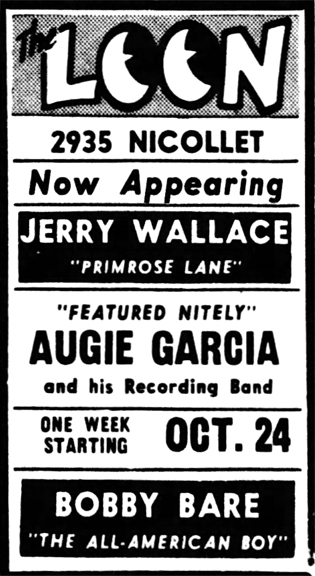
October 24, 1961: Bobby Bare
A LITTLE BIT COUNTRY
Still trying out styles, the Loon started bringing in national C&W acts.
November 7 -12, 1961: Pee Wee King, the Collins Sisters, Redd Stewart, the Golden West Cowboys, and local favorite Texas Bill Strength.
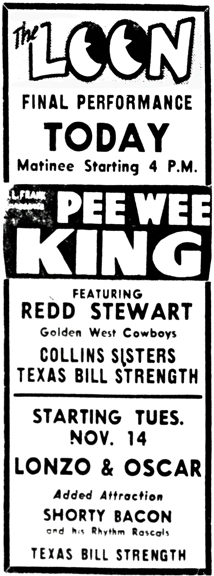
November 14, 1961: Lonzo and Oscar, Shorty Bacon and his Rhythm Rascals, Texas Bill Strength
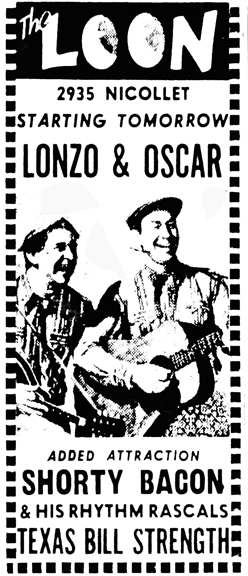
November 25, 1961: Jerry Reed
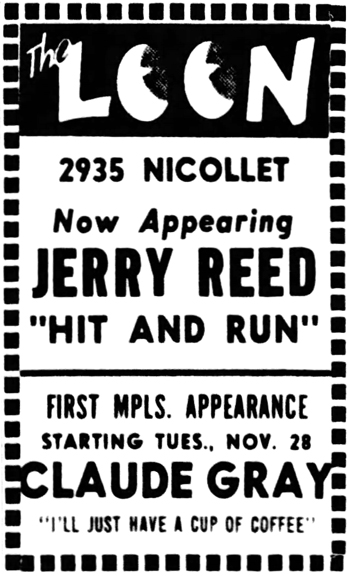
November 28 – December 3, 1961: Claude Gray, Jan and Patti North
December 4, 1961: The Loon Club instituted Scandinavian Night on Mondays, featuring Louie’s Twin City Concertina Band
December 5 – 10, 1961: Wanda Jackson
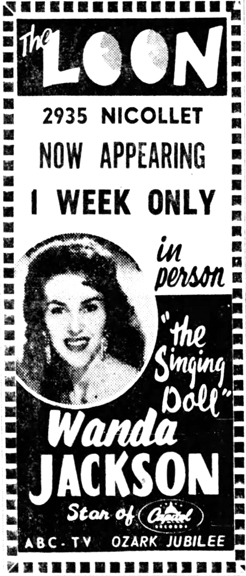
December 16, 1961: Bobby Edwards
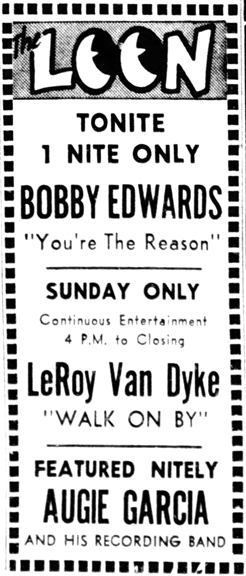
December 17, 1961: Le Roy Van Dyke
1962
A LITTLE BIT ROCK ‘N’ ROLL
Maybe the Loon couldn’t compete with the Flame, so the owners took a different tack, bringing in an incredible stable of national rockers, with local hero Augie Garcia as the house act.
February 3, 1962: Battle of the Bands – Roscoe and the Green Men vs. Augie Garcia
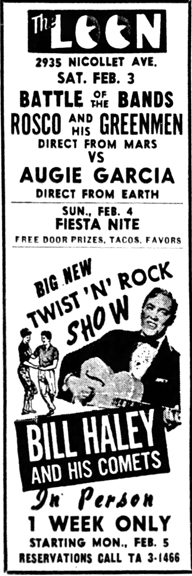
February 5 – 10, 1962: Bill Haley and His Comets
February 12, 1962: Tony and the Knights (“Peppermint Twisters”)
February 17, 1962: Tony and the Knights (“Peppermint Twisters”) vs. Augie Garcia (“Taco Twisters”)
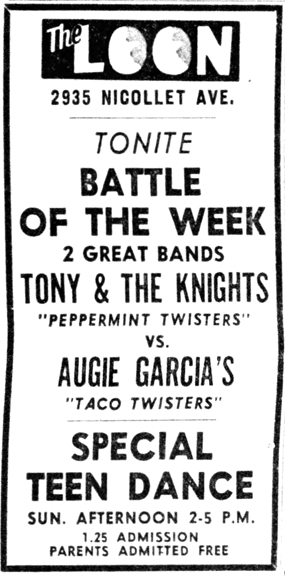
March 12 – 17, 1962: The Champs
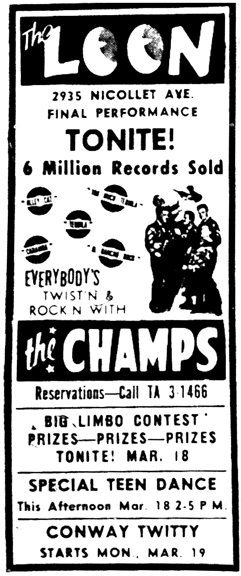
March 19 – 24, 1962: Conway Twitty. Will Jones reported that Twitty had developed a nightclub act, but the “cavernous interior of the Loon Club” was not conducive to the material, so he and his group mostly played music for dancing, including the twist, an inescapable phenomenon in 1962. On Saturday, March 24, the Loon featured Twitty in a special Tournament dance for the kids in town for the Boys’ High School Basketball Championship.
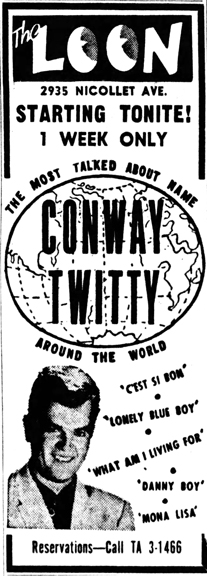
March 25, 1962: The Durados
March 26 – April 1, 1962: The Mar-Ketts (“Formerly the Hollywood Argyles”). Who knows who these guys were, since both the Hollywood Argyles and the Markettes were studio groups. But I like their skinny ties.
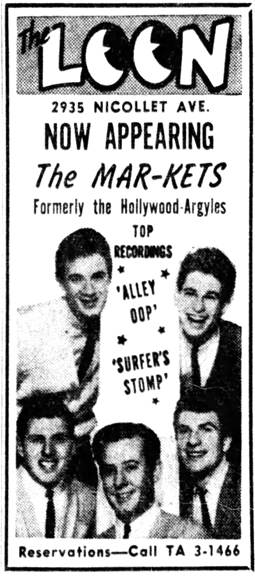
April 2 – 8, 1962: Buddy Knox and the Rhythm Orchids
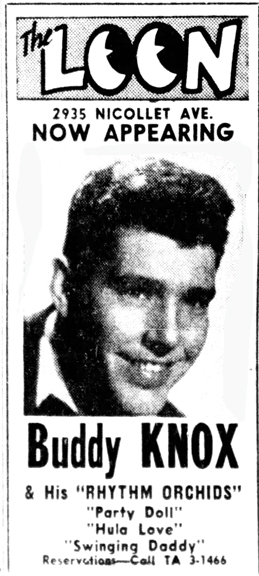
April 9 – 15, 1962: Jerry Lee Lewis
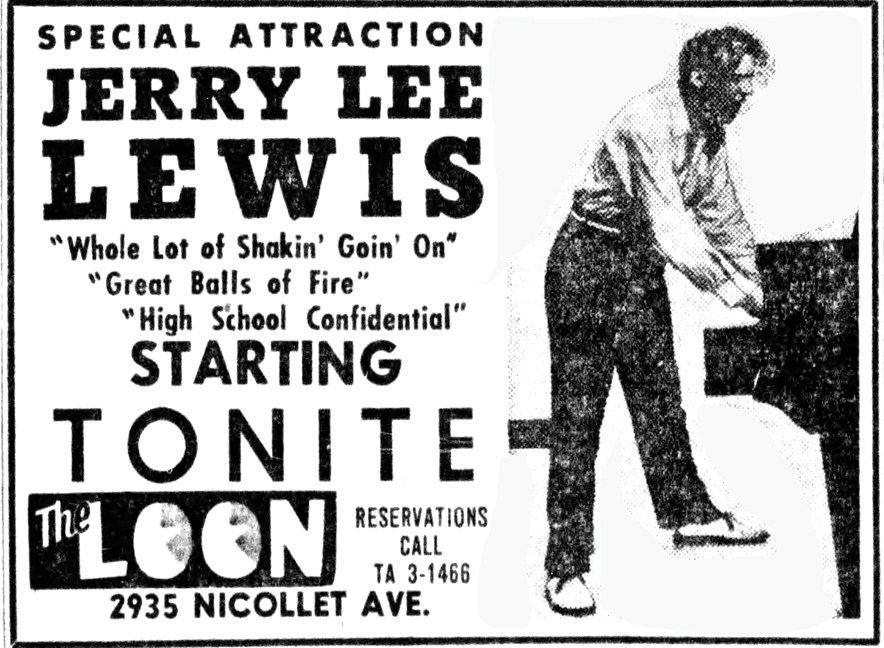

Minneapolis Tribune
May 1 -6, 1962: Kalin Twins
May 7 – 13, 1962: The Champs
May 14 – 20, 1962: Bo Diddley
* The Star and Tribune went on strike in May 1962, and the slack was taken up by the Minneapolis Daily Herald. Robb Henry put together the collage of ads below showing the 1962 ads that were printed in the Herald.
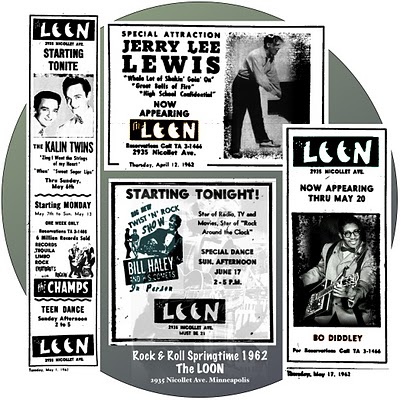
June 11 – 17, 1962: Bill Haley and His Comets. Not sure where this ad came from.
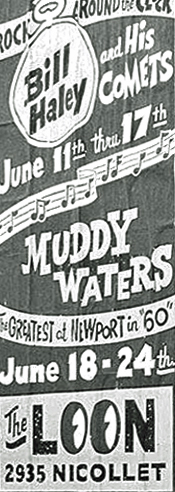
June 18 – 24, 1962: Muddy Waters
DOWN TO EARTH
At this point perhaps the money ran out for more national acts, and the club reverted to local bands, which it became known for.
August 31, 1962; The Diablos
September 1, 1962: The Dorados
September 2, 1962: Tommy Francis
September 3 – 9, 1962: The Sonny Williams Quartet
September 12 – 16, 1962: The Fendermen
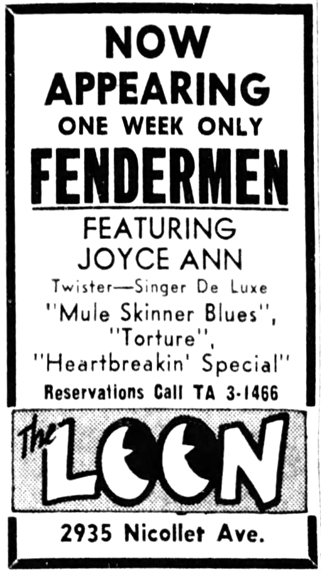
October 4 – 7, 1962: The Blazers: “Hottest Band This Side of Hades”
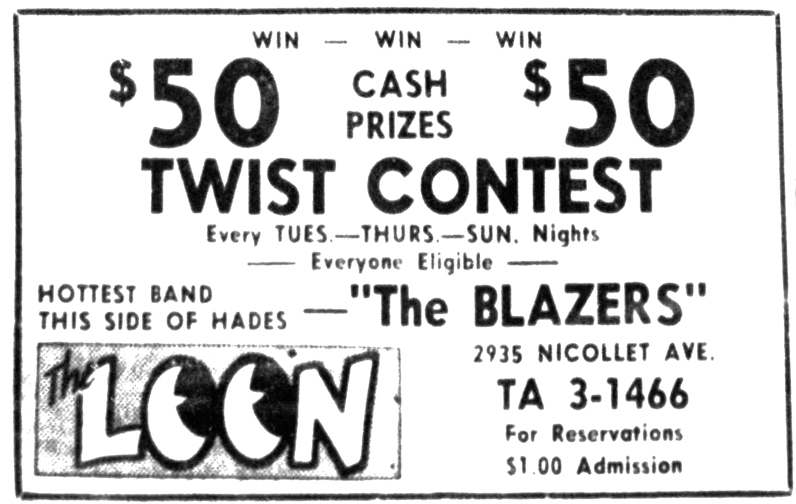
October 9 – 14, 1962: Roscoe and His Little Green Men. You can’t tell it here, but these guys sported green hair.
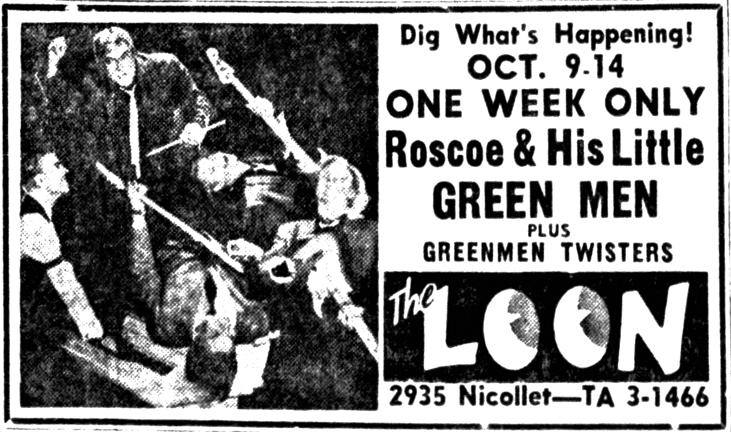
MR. LUCKY’S
1962
Mr. Lucky’s opened in December 1962 as the only local night club devoted exclusively to teenagers. Mr. Lucky himself was apparently a guy with a top hat, tails, a cane, and some nifty boots.
One of – if not the – first bands to play at Mr. Lucky’s was Mike Waggoner and the Bops. Terry and the Pirates played on Sundays.
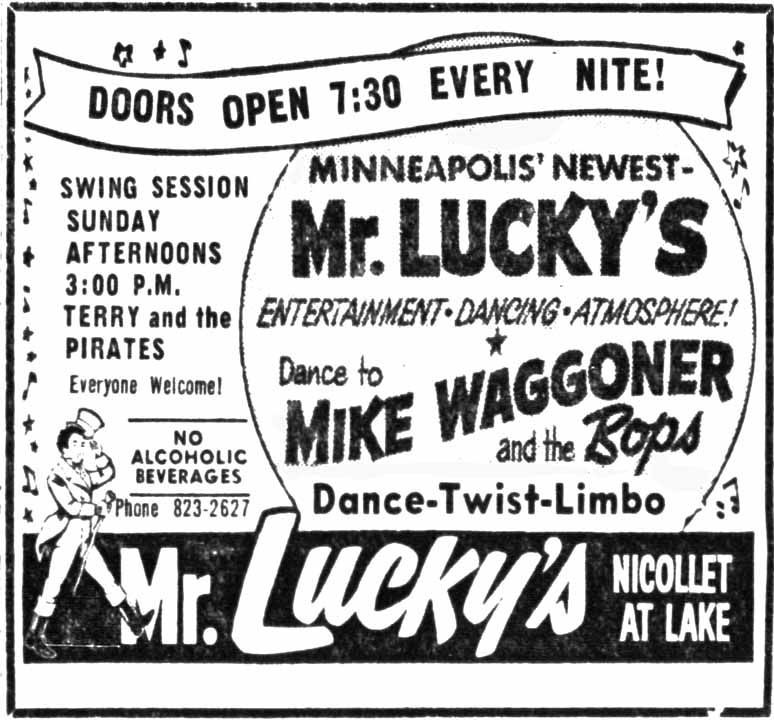
1963
Mr. Lucky’s did not seem to get off to a good start. The only items I found were disturbing:
In February 1963, a 20-year-old young man with a St. Louis Park address went to the police station to protest the arrest of a friend for disturbing the peace at Mr. Lucky’s. He fought with the police in the car and at the station, breaking a glass pane in a door. He was admitted to General Hospital after he fell on the floor in the Court House, thrashed around wildly, and finally collapsed. Turned out he had taken 9 or 10 barbiturates.
Then in November 1963, a 19-year-old former Upper Midwest Golden Gloves boxing champion was found guilty of beating up a 17-year-old and knocking out four of his teeth. The cause? The victim danced with a girl friend of the assailant.
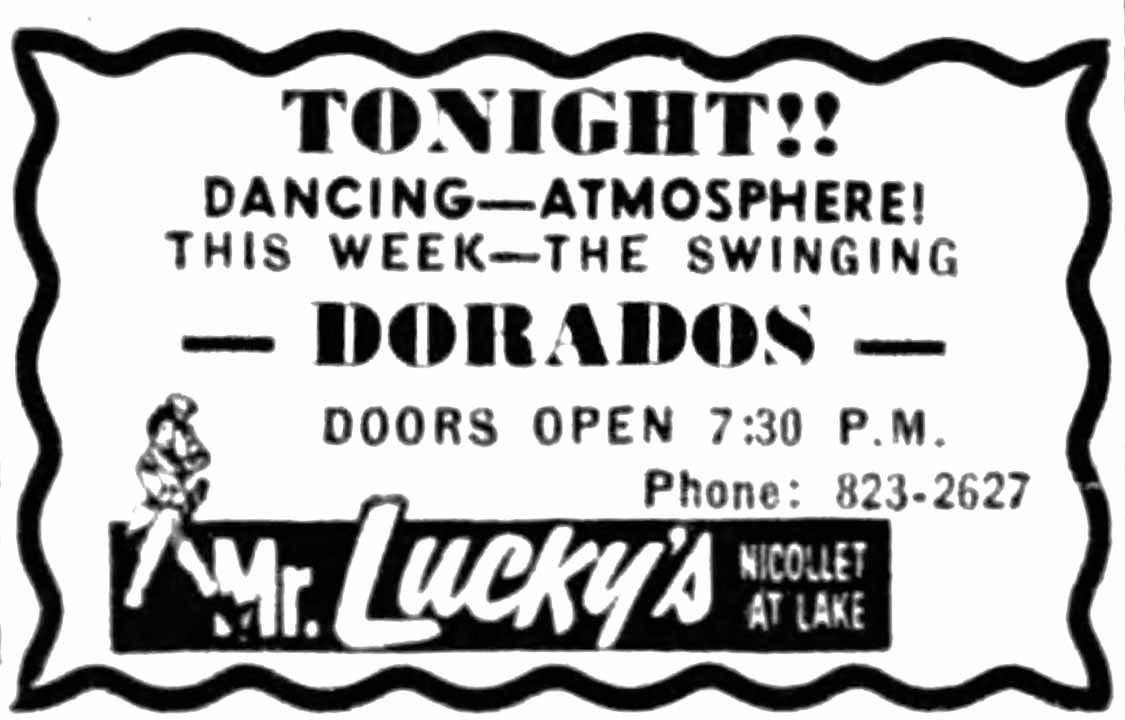
January 23, 1963
Mike Waggoner and the Bops played frequently at Mr. Lucky’s in 1963.
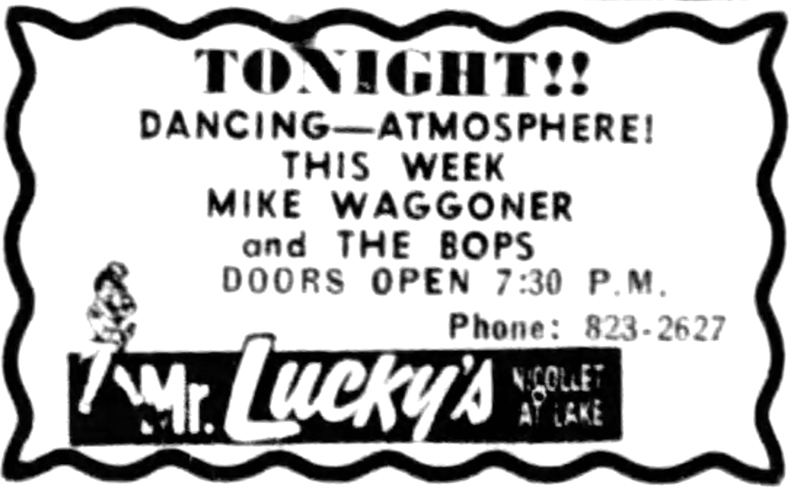
January 30, 1963
The Trashmen played Mr. Lucky’s on March 23, 1963. This was when the T-Men were still a popular local surf band; “Surfin’ Bird” would be released on November 13, 1963. (Thanks, minniepaulmusic.com!)
May 31, 1963: The Accents
1964
Mr. Lucky’s dodged a bullet in 1964 when there was pressure not to renew its license. The problem apparently started in the early hours of February 9, when 11 police cars called in to quell a disturbance. Over 200 kids were milling around after midnight as two cops were tagging a car with a noisy muffler.
The motorist’s companion “got a little mouthy,” according to police, and because of so many persons on the sidewalk, help was called for. “Mr. Lucky’s has become an attractive nuisance as far as we’re concerned,” [Ray Williamson, head of the Minneapolis Police Crime Prevention Bureau] said. “Some of my officers are outrightly indignant about the environment there. There is no question that there’s drinking going on in the place. The kids bring in their own bottles and spike the soft drinks.”
The club was owned by Rostar, Inc., and John R. Stephens was a co-owner. Stephens insisted that they were doing the community a service by keeping kids off the streets. The club was managed by Brian K. Lawson, a student at the U of M.
The timing was bad, since the club’s license was due for renewal on April 1. Other accusations against the club included:
- Cramming 1,200 bodies into a room rated for 500 (one article said a typical weekend night count was 700)
- Kids popping pep pills or “goof balls”
- Harboring known narcotics users
- Patrons fighting
Russell Green, police licenses inspector, complained that Mr. Lucky’s was requiring too much enforcement work by regular policemen, citing 32 police calls from November 1963 to February 1964. Most involved drunkenness, breach of the peace, or exchange of those pep pills.
One particular incident cited by police was vandalism of a “nearby beauty salon, which suffered $500 damage to the interior one dance night in December when vandals broke in and threw bottles of hair rinse and shampoo on the ceiling and walls.”
Stephens said that the club was supervised by three off-duty policemen, a half dozen waiters from the U of M, check room operators, and a manager.
Minneapolis Mayor Arthur Naftalin reported that he and his wife paid a visit to the club on a recent Saturday night and found nothing improper, but that “one visit was no basis for an over-all evaluation.”
“Asked what he thought would happen if Mr. Lucky’s were closed, a 17-year-old commented: “It’s just going to cause more trouble, because where are the kids going to go?”
Up against a council timing problem, Mr. Lucky’s had to close between April 1 and 10, 1964, when their license was finally renewed.
- Voting for renewal, Alderman John Johnson said “I’d rather see them in a dance hall in the city of Minneapolis than in a roadhouse 20 or 30 miles out.”
- Alderman Mrs. Elsa Johnson also voted for renewal, saying “The people in the area are very happy to have a fine place where their children dance in a wholesome atmosphere.”
- Alderman Robert MacGregor was reluctant, but said, “If it’s true, as they say, that there are no other places for teenagers to go on Friday and Saturday nights, then I think this is an indictment against our community.”
1964 Entertainment:
1964 started out with a full lineup of bands that we think of today as the golden era of local Twin Cities dance bands of the mid-sixties:
January 10-12, 1964: The Accents
January 17-19, 1964: Keith Zeller and the Starliners
January 24-26, 1964: Tim and the Galaxies
January 31 – February 2, 1964: Gregory Dee and the Avanties
February 7 – 9, 1964: The Accents
February 14 – 16, 1964: Mike Waggoner and the Bops
February 21 – 23, 1964: The Jades
February 28 – March 1, 1964: The Underbeats
Rod Eaton of the Underbeats had this to say about Mr. Lucky’s:
Mr. Lucky’s was one of my favorite places to play. The Underbeats and T. C. Atlantic played there frequently – including at least one New Year’s Eve gig each. The place dubbed itself “the Twin Cities’ first teen night club.” Fridays and Saturdays they routinely packed in about double the Fire Marshall’s occupancy limit. Unfortunately Mr. Lucky’s wasn’t so when it came to bad press. Fights were common – two rival clubs laid claim to the place. Uniformed cops watched the door and prowled the floor. In those pre-dope days, kids made do with traditional soft drink spiking. So all in all Mr. Lucky’s was a fun and exciting place to gather, dance, cruise, and play. Every night was an adventure. Those great 60s teen dance places vanished years ago. I feel sorry for today’s teenagers. They don’t get to hang out and listen and dance to real bands. DJ hosted parent/teacher chaperoned school hops just don’t provide the same experience.
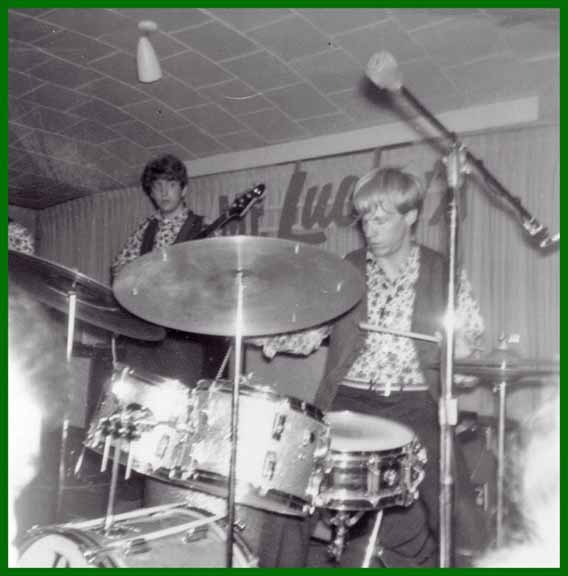
Undated photo of TC Atlantic, courtesy Rod Eaton (pictured on drums)
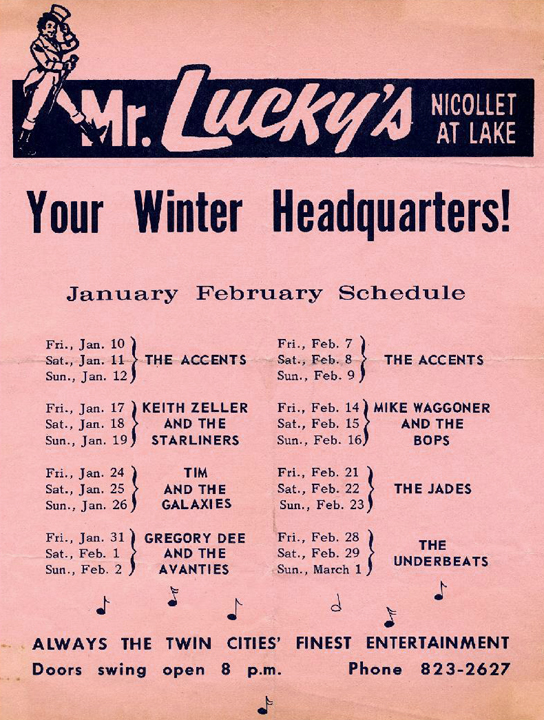
Courtesy minniepaulmusic.com
Rod Eaton also furnished this fabulous photo of the sign – obviously the Friendship Club sign covered up.
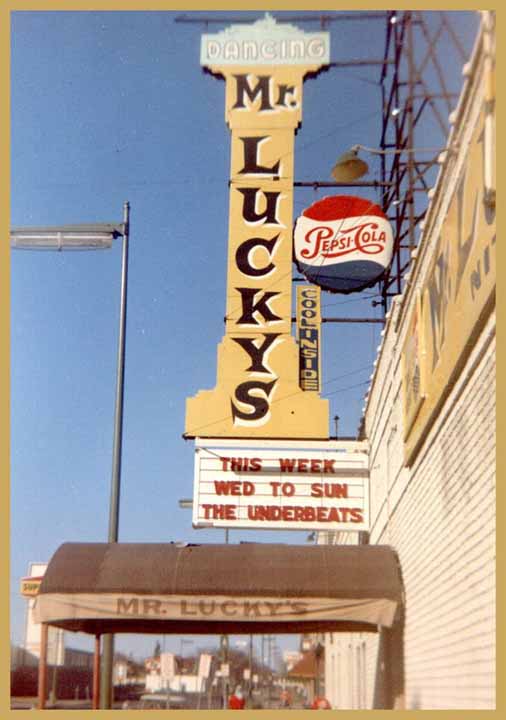
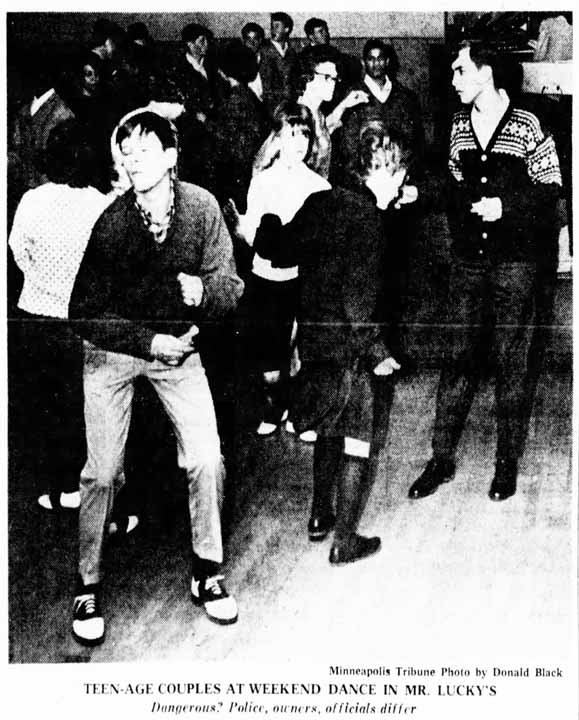
March 9, 1964, Minneapolis Tribune
August 28, 1964: Battle of the Bands – The Chancellors vs. The Renegades
August 29, 1964: The Chancellors
On August 30, 1964, Mr. Lucky’s sponsored its first annual scholarship dance. Proceeds provided scholarships to two freshmen at the U of M. Recipients were selected by the University Scholarship Committee. Entertainment was provided by local bands the Underbeats, the Accents, and the Chancellors.
Thanksgiving break brought the best of the local bands to Mr. Lucky’s:
November 25, 1964: The Chancellors
November 26, 1964: The Accents
November 27, 1964: The Castaways
November 28, 1964: The Novas
November 29, 1964: The Underbeats
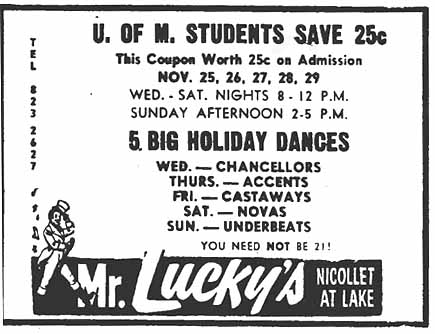
Minnesota Daily
1965
In 1965 Mr. Lucky’s was expanded, and was open on Wednesday, Friday, and Saturday nights and Sunday afternoons. That year the owner was identified as Bob Roosen and the manager was Bryan Lawson.
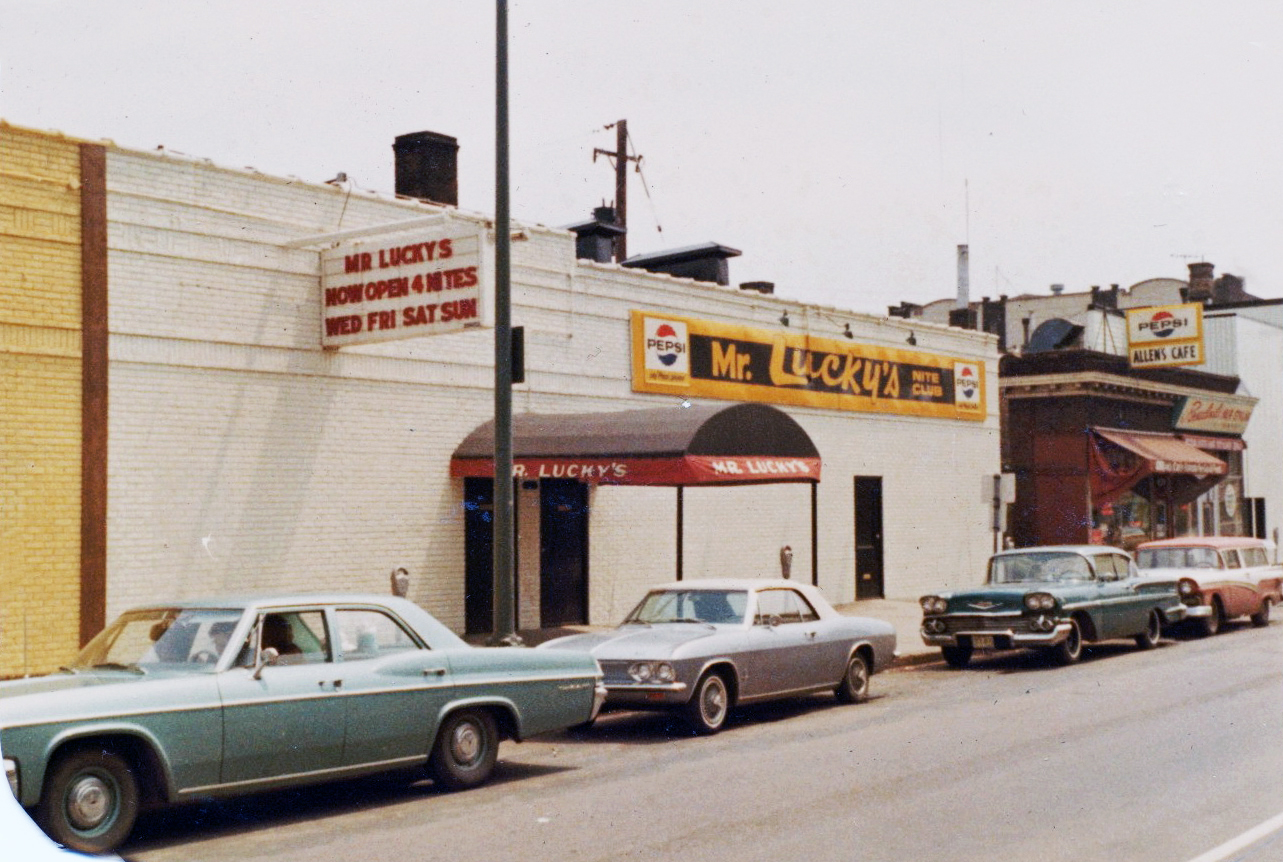
1965 Photo by deceased relative of Infrogmation, inherited and scanned by Infrogmation
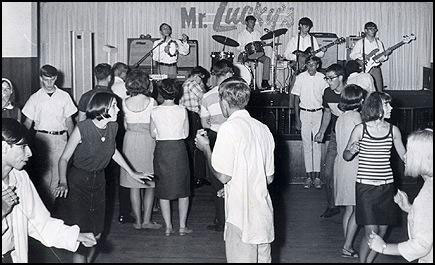
1965 – Dudley and the Doo Rytes! Thanks, Tom Husting!
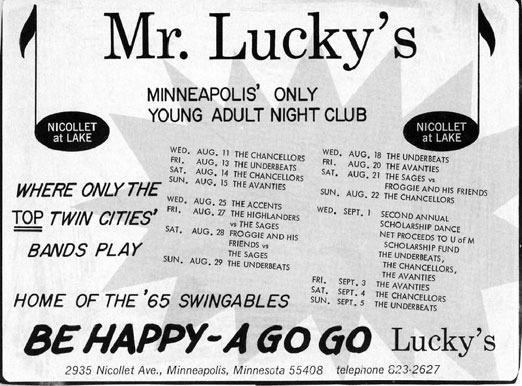
August 1965
September 1, 1965: Mr. Lucky’s Second annual scholarship dance featured Gregory Dee and the Avanties, the Chancellors, and the Sages.

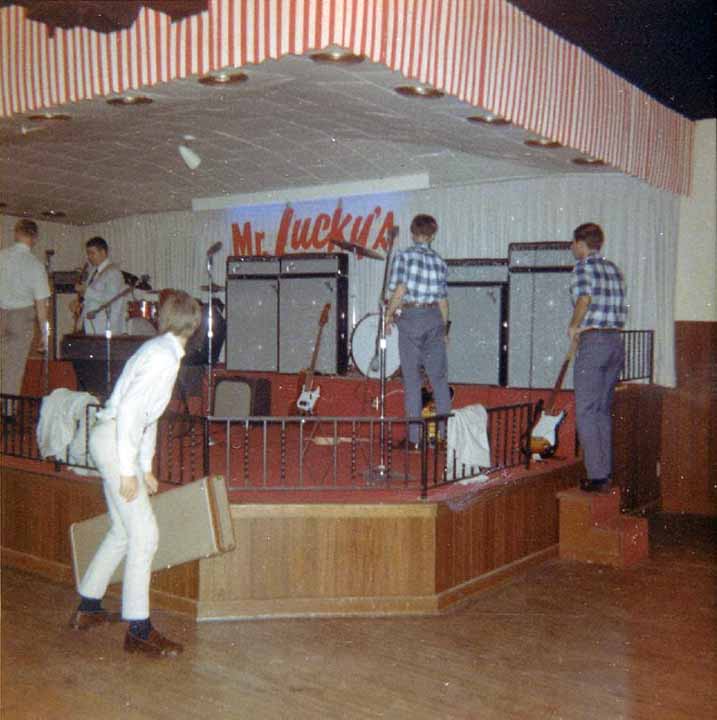
Undated photo courtesy minniepaulmusic.com
1966
Mr. Lucky’s Third Annual Scholarship Dance was held on August 28, 1966. Bands included Michael’s Mystics and Stillroven. Proceeds were used to set up two full-year scholarships for freshmen at the U of M.
December 17, 1966: City Strangers
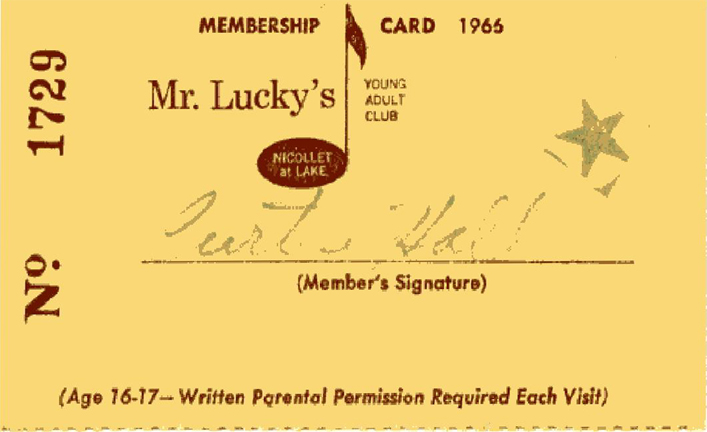
1966 Membership card – Image courtesy minniepaulmusic.com
MAGOO’S
The story of Magoo’s is told following the section on the New City Opera House – the tale isn’t exactly linear. The space started out as a Post Office, and became Magoo’s in 1965. Concerts between the end of 1967 and the end of 1970 were identified as taking place at Magoo’s, the New City Opera House, or sometimes Magoo’s New City Opera House. Apparently the bands alternated. I have listed all those concerts below under Magoo’s/NCOH, since it’s hard to tell (unless there’s a photo) who played at which stage. They were good concerts with a great mix of national and local acts. I’m sure there were more than listed.
NEW CITY OPERA HOUSE
Mr. Lucky’s was renamed the New City Opera House by ace guitarist Zippy Caplan, who was working there between gigs, in about 1967. Zippy says the name just came to him – there was no contest as previously reported. At that time the manager was Gary Jorgensen.
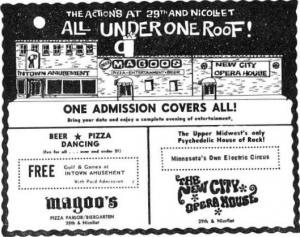
1967
December 9, 1967: Shadows of Knight, NCOH. With the Electras.
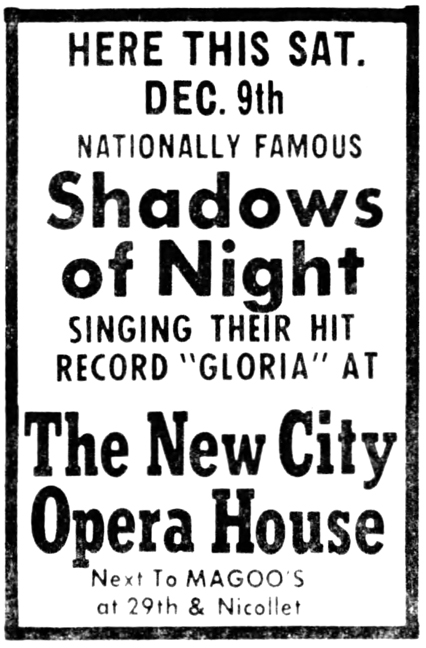
December 30, 1967: The Litter, T.C. Atlantic, C.A. Quintet, Happy Dayz, and the Grasshoppers.
December 31, 1967: The Litter, Grasshoppers, Nickel Revolution, Love Express, Xpressmen
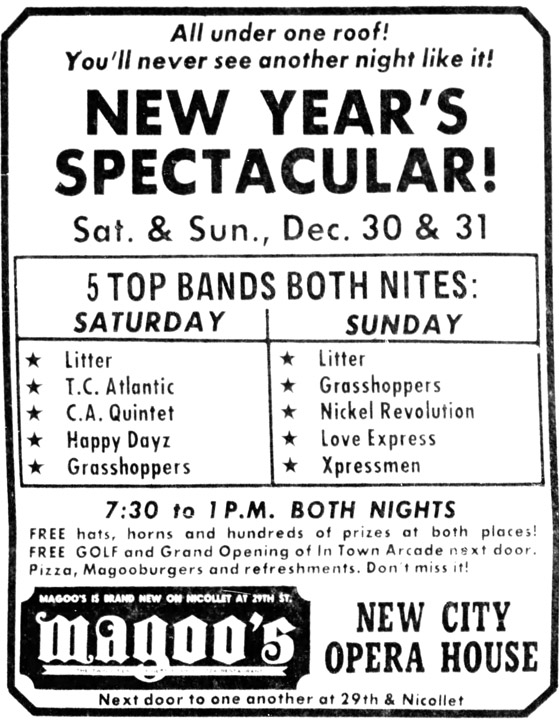
1968
In 1968 New City was advertised as “The Upper Midwest’s only Psychedelic House of Rock!” and “Minnesota’s Own Electric Circus.”
January 12, 1968: Lemon Pipers, NCOH
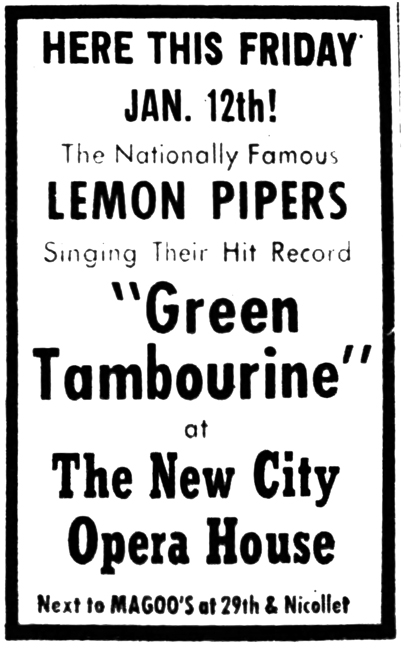
February 29, 1968: South 40, a successor to the Castaways
March 1, 1968: The Litter, Split Level, the Del Counts, Noah’s Ark
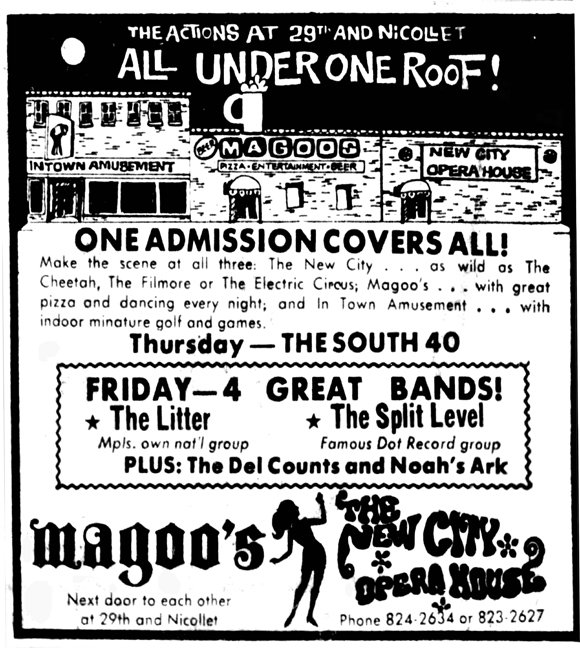
May 3, 1968: The Castaways, Jokers Wild, Canoise
May 4, 1968: The Litter, The Paisleys, Susie Q and the Originals
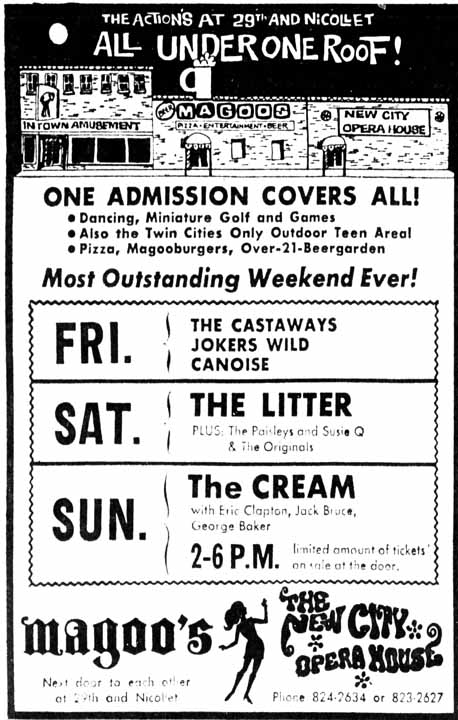
Minneapolis Tribune, May 3, 1968
CREAM, NCOH
On May 5, 1968, Cream underwhelmed the audience at the New City Opera House, and vice versa. Read the story here.
New Year’s Eve 1968:
- Stillroven
- White Lightning
- South 40
- Canoise
- Del Counts
- Flight – soon to become Pepper Fog
- Youngsters
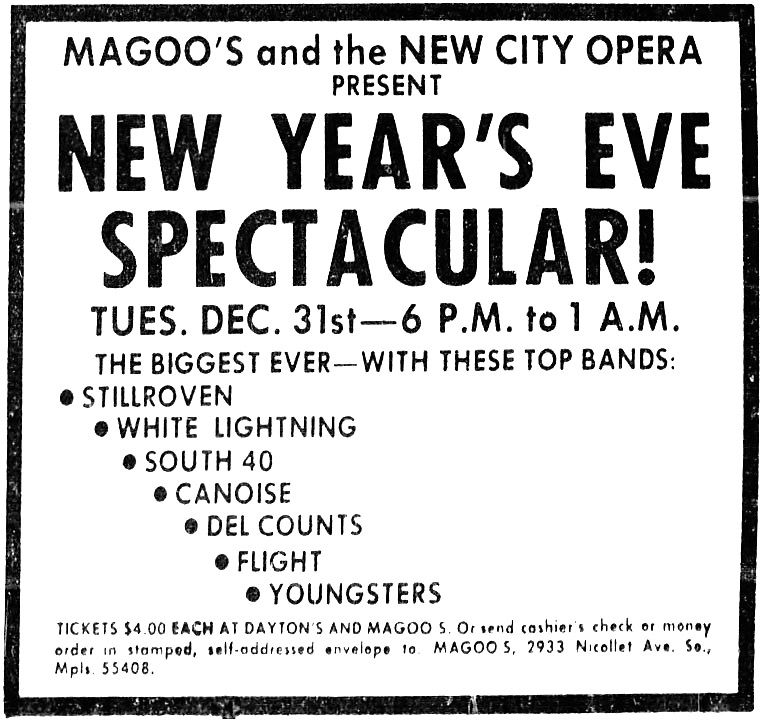
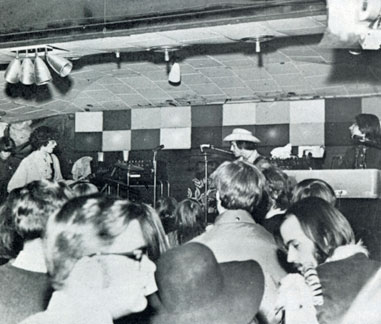
Stillroven at NCOH – Photo copyright Mike Barich, St. Paul
Zarathustra was one of the bands at Magoo’s New Year’s Eve party.
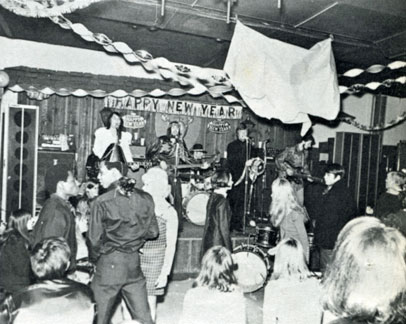
Zarathustra at Magoo’s, December 31, 1968. Photo copyright Mike Barich, St. Paul
1969
February 9, 1969: 12 bands, including White Lightning and Orpheus
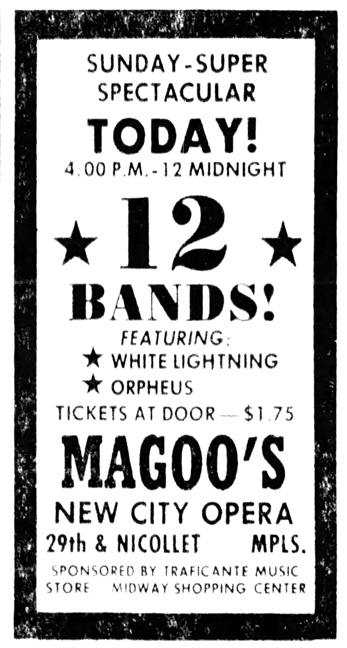
February 14 – 15, 1969: Friend and Lover (probably NCOH)
March 7-8, 1969: Sweetwater, NCOH. Also local acts Blackwood Apology and Zarathustra.
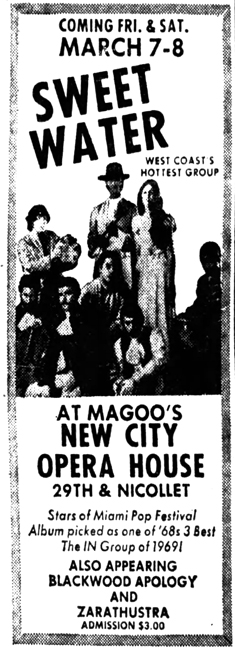
September 28, 1969: C.A. Quintet
SANTANA, NCOH
October 16, 1969: Santana, opened by the Paisleys and Triad. In a review of a return appearance several years later, Marshall Fine remarked that there were 500 people in the audience and the “fledgling band pounded out some of the fiercest, rawest Latino rock I had heard.” (Another report was that there were only 75 people there.) Fine noted that the 1973 performance at the Met Sports Center was much different, with smoothed out edges and added depth reflecting Carlos Santana’s spiritual journey.
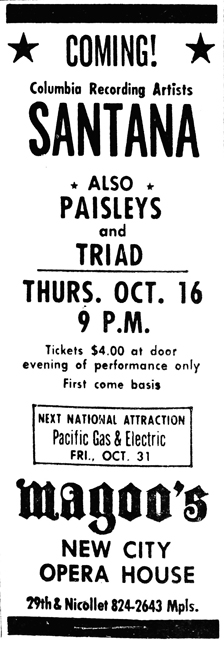
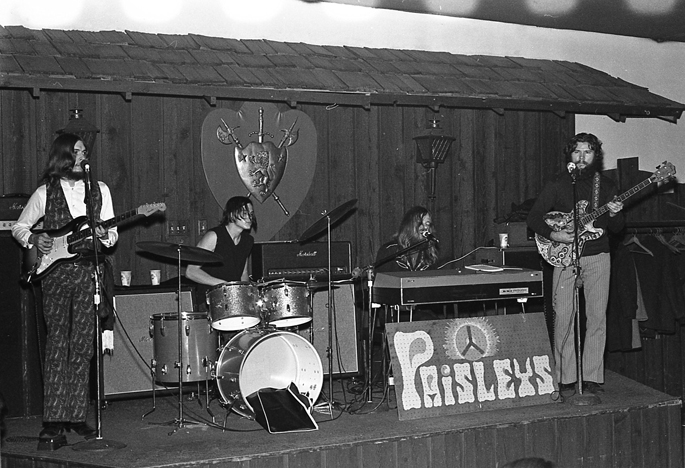
The Paisleys at Magoo’s, October 16, 1969. Photo copyright Mike Barich, St. Paul
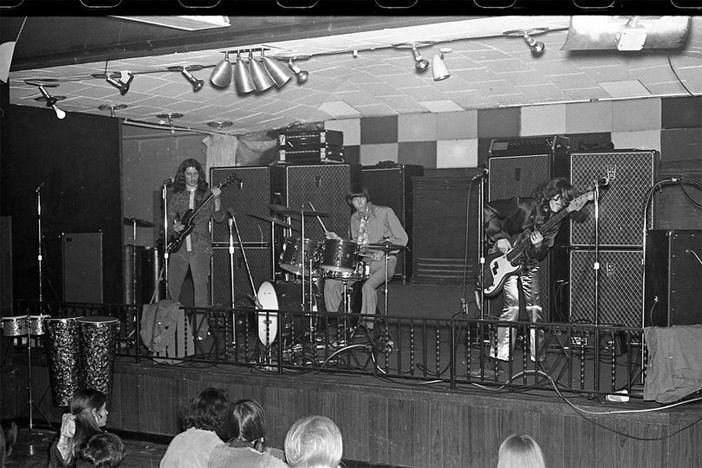
Triad at the Santana show, NCOH. Photo copyright Mike Barich, St. Paul, courtesy Mike Mankey
PACIFIC GAS & ELECTRIC, NCOH
October 31, 1969, with the Grasshoppers and Pride and Joy.
Marshall Fine’s review was fierce:
To discuss Pacific Gas and Electric is to discuss adequacy. Talking about them is talking about being average. Describing them is describing mediocrity. Listening to them is unequaled boredom.
For PG&E are, without a doubt, the most average, most adequate, most mediocre and therefore most boring group around.
Friday night at the New City Opera House, they tried to play what they consider to be very heavy blues. But it is just a rehash of everything Muddy Waters and B.B. King and John Lee Hooker ever did.
They do not have the power of a blues band like Paul Butterfield’s or the uniqueness of a Johnny Winter. They play just plain middle class ordinary electric blues, with the right sprinkling of “oh babys” and “oh mamas” to pass.
The whole problem is they got away with it. They had the crowd screaming and whistling and shouting for more.
But, after all, there is no accounting for tastes.
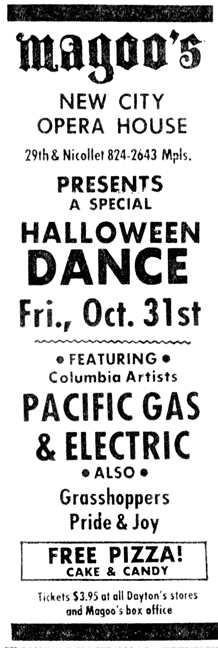
NEW COLONY SIX, NCOH
November 29, 1969, opened by Lemon Pepper
BLUE CHEER, NCOH
December 8, 1969, opened by White Lightning and Happy Dayz.
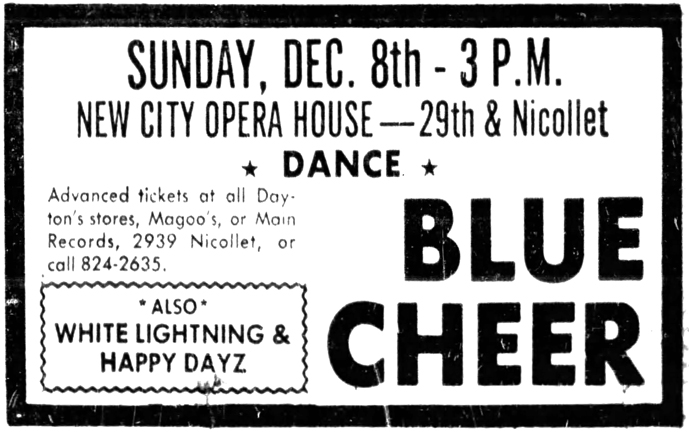
Minneapolis Tribune
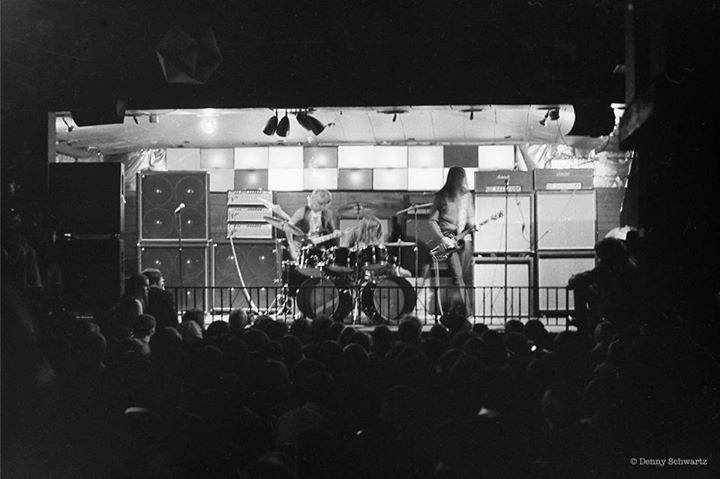
Photo of Blue Cheer at NCOH by Denny Schwartz
ZEPHYR, Magoo’s
December 12 – 13, 1969: Zephyr’s performance was reviewed in the January 16, 1970, edition of the Minneapolis Flag:
Magoo’s audience loved them. I loved them. My old lady loved them. And the ZEPHYR loved them. “Man,” Candy [Gibbons] told me in an interview after the show, “before we came up here we’d heard reports… bad reports…about Minneapolis. We were told we wouldn’t dig it. Our promoters said, ‘Be glad that Minneapolis is your first gig because you won’t like it.’ … But they were wrong. All wrong.” Put that in your hookah and smoke it. ZEPHYR felt the Midwest to be turned on more than they had figured. Nothing but life, love, sex , and energy emerged from this group of fine musicians. They’re definitely not the death rattle of underground music (as they have been called at times). On the contrary, man,… they’re going through some positive and fruitful changes.
1970
COLD BLOOD
January 30 – 31, 1970: Cold Blood was a group from San Fransisco featuring vocalist Lydia Pense.
SPIRIT AND ZEPHYR
March 8, 1970. Nova Lights and a new stage.
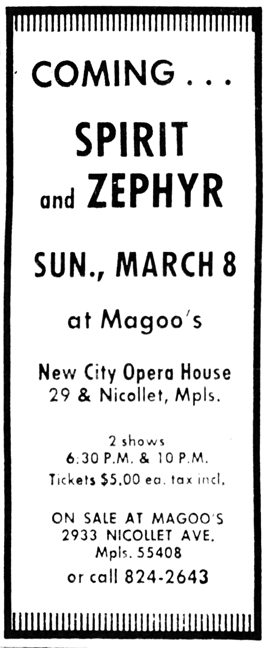
November 14, 1970: An article in the Star noted the lack of business at all of the teen dance halls in the ‘Cities, attributed to the rise of festivals and concerts. At Magoo’s/New City Opera House, only 100 kids were dancing in a space that could hold 1,500. Manager Gary Jorgenson said that if business doesn’t pick up, the hall would close. In January 1971 the Insider reported that owner Bob Roosen turned the NCOH over to the Mystics to run, but that didn’t work out either.
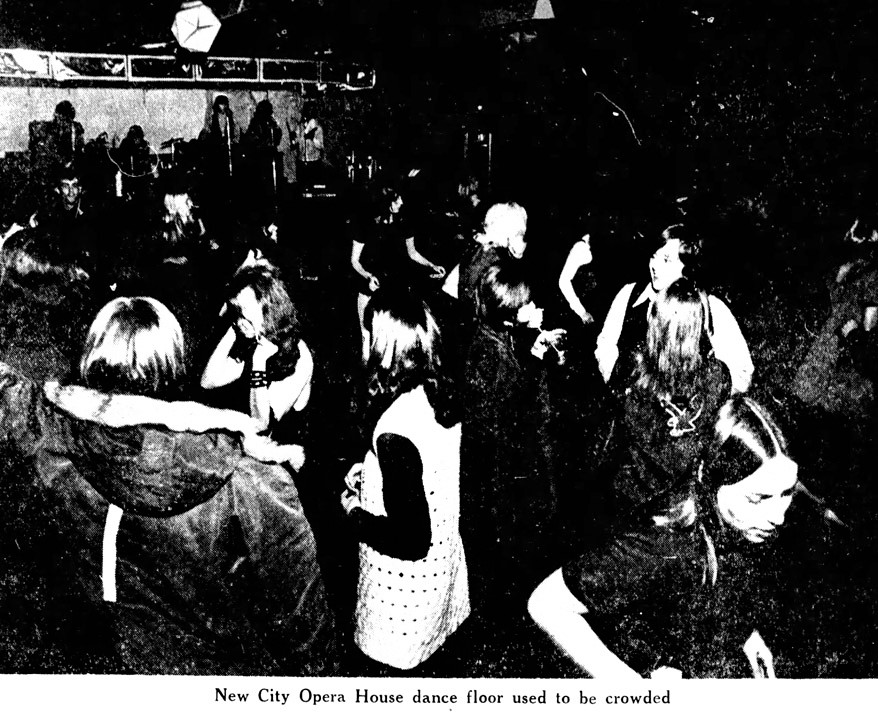
Apparently Bobby Jackson, who rented the Magoo’s side (see below) from November 1970 to April 1971, also ran the NCOH. Both got trashed in the April 1971 riot.
2933 NICOLLET: MAGOO’S
POST OFFICE
In April 1952 a portion of the Friendship Club was altered to create the Lake-Nicollet branch of the Post Office, transferred from 117 West Lake Street. The 9,500 sq. ft. section of the building, with a 58 ft. frontage, was leased for ten years from Mrs. Kathryn Brecheisen, the owner of the Friendship Club. The Post Office had 79 employees, including 68 carriers. The Superintendent was Charles Becker.
In December 1963 it was announced that the space was “inadequate” and a new location was required.
MAGOO’S
1965
Magoo’s pizza parlor replaced the Post Office in April 1965. It was next to Mr. Lucky’s and was under the same management: owner Bob Roosen and manager Brian Lawson.
A long ad announcing its opening was published in the Strib on April 22, inviting people to “Enjoy an Irishman’s Italian Pizza in a Bavarian decor while you listen to cool live jazz in a family atmosphere.” It boasted that it was the world’s largest pizza parlor, seating 432 people and serving 28 kinds of Beek’s pizza. “There’s a giant open hearth fireplace, wooden chairs and tables, a bandstand which everyone can see, and an amusement lounge up front.” Will Jones wrote that the waiters wore lederhosen. He also reported that there was no liquor or beer, but it probably served beer from the outset.
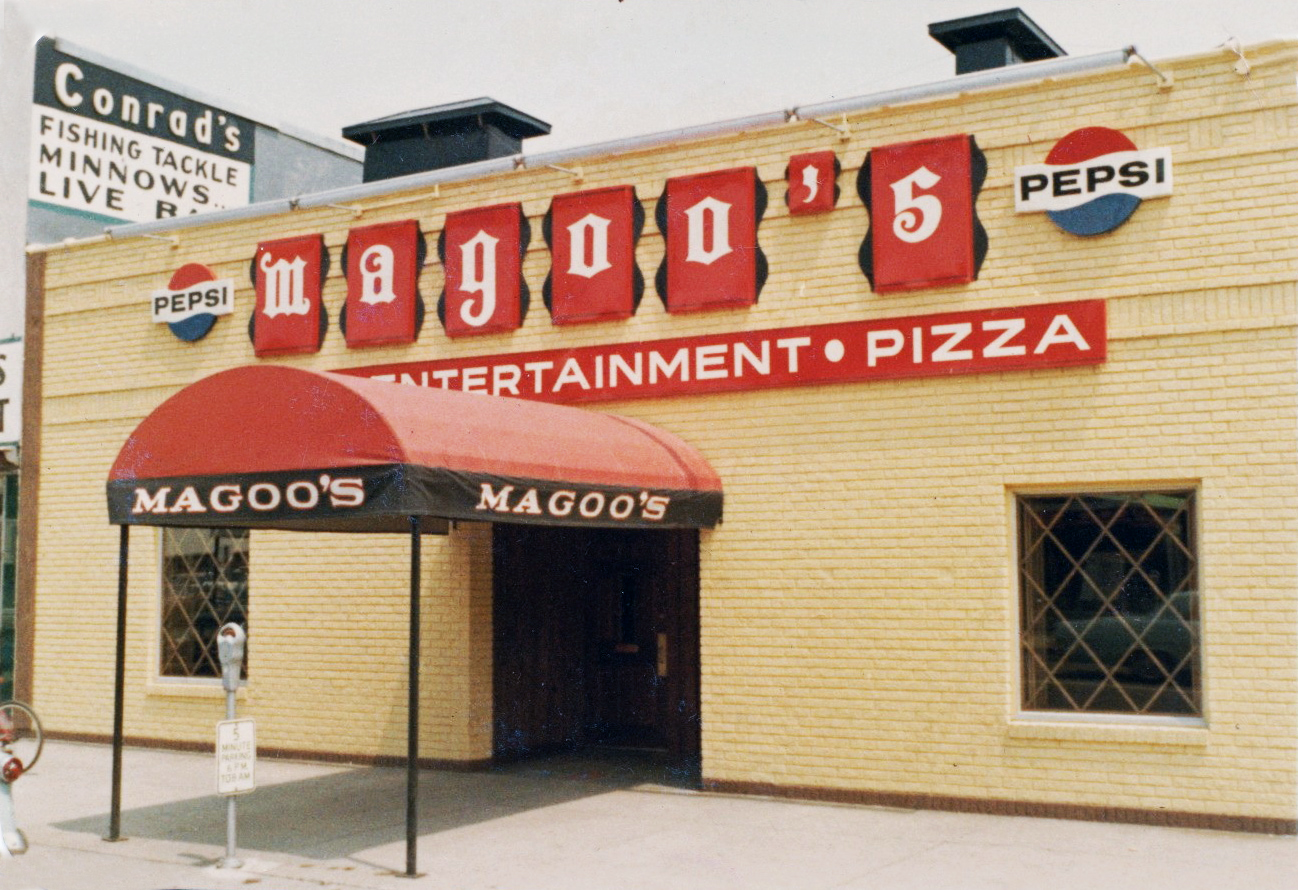
1965 Photo by deceased relative of Infrogmation, inherited and scanned by Infrogmation
Starting on April 2 – 3, KQRS program director Herb Schoenbohm’s Jazz Trio provided the music on Friday and Saturday nights. By September the Mike Elliott Trio, originally from Denver, played on Thursday and Sunday nights. Will Jones expressed his gratitude for this difference from Shakey’s banjo music. He noted that “between musical numbers, and sometimes during them, the ticket-numbers of pizza orders were boomed over the microphone. An indefatigably polite and pleasant crew of young men kept the system functioning smoothly.”
Owners were so optimistic about the success of Magoo’s that they were planning a second Twin Cities location, and were planning to sell franchises.
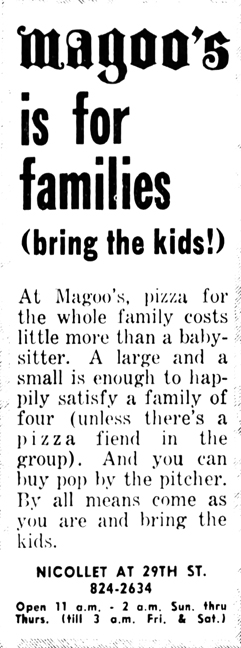
June 8, 1965
An ad from July 1, 1965, had reduced the number of types of pizza from 28 to 14 – perhaps they had dispensed with the tuna variety. Yech! That ad also did not mention beer.
In September, Will Jones compared Magoo’s to Shakey’s Pizza:
The same long, low benches for tables; the same short, sturdy stools; the same kind of serve-yourself setup for ordering pizza and light and dark German-style beer; roughly the same noise level; and the same sort of camaraderie that results from such calculated jammed-togetherness, especially on weekend nights.
In the October 1965 issue of Twin City a-Go-Go, local comedian Danny Klayman likened Magoo’s to an Italian resort with beautiful decor. Tuesdays featured turtle races (bring your own or rent one), and on Monday through Wednesdays they showed “Magoovies” – Three Stooges, Laurel and Hardy, etc.
A large ad in November mentioned the Biergarten and live jazz, but still encouraged people to bring the family. A noon buffet had also been added.
1966
In 1966 the music at Magoo’s changed from jazz to what looks like Dixieland and “singalong” music. The stress was still on a family pizza parlor.
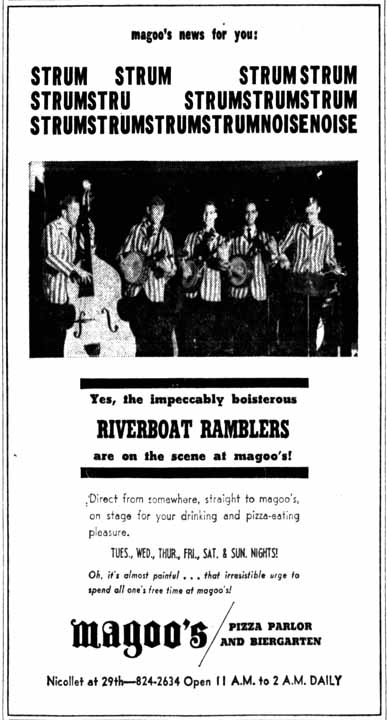
April 15, 1966
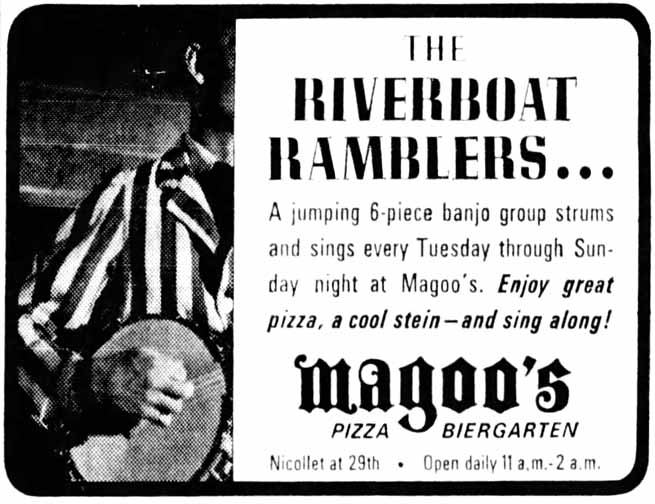
April 22, 1966
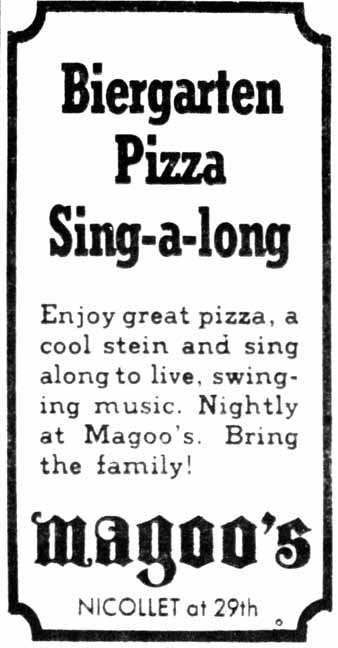
July 6, 1966
MAGOO’S SURRENDERS TO ROCK ‘N’ ROLL
On August 5, an ad substitutes Rock & Roll for Sing-a-Long, signalling the turning point for Magoo’s.
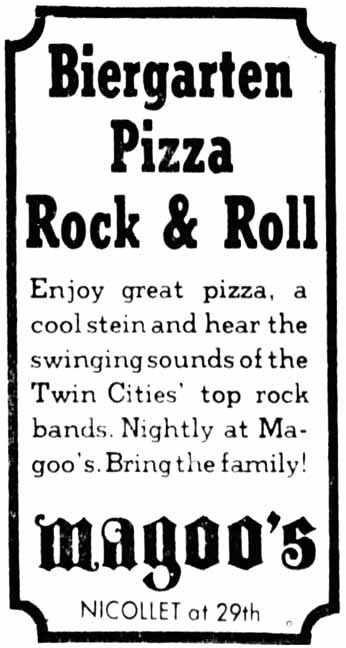
August 5, 1966
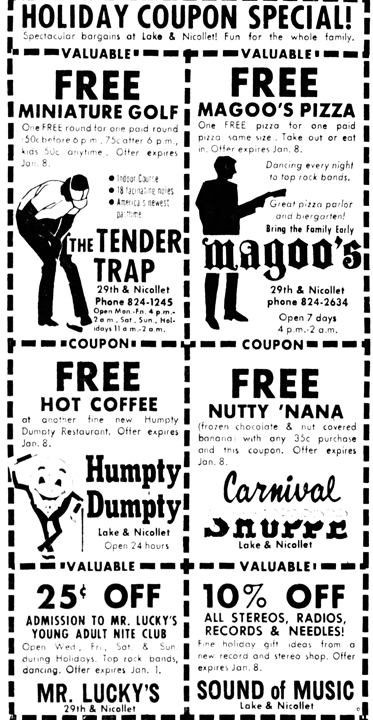
December 22, 1966. It would appear that the Tender Trap Mini Golf course was in the building to the north of the Magoo’s/Mr. Lucky’s building.
1967
In 1967 Magoo’s was managed by Gary Jorgensen, who announced that June that the dance floor had been expanded. Owner Bob Roosen had three windows installed in the north wall.

April 2, 1967
MAGOO’S AND THE NCOH
Concerts between the end of 1967 and the end of 1970 were identified as taking place at Magoo’s, the New City Opera House, or sometimes Magoo’s New City Opera House. Apparently the bands alternated. I have listed all those concerts up above under Magoo’s/NCOH. They were good concerts with a great mix of national and local acts. I’m sure there were more than listed.
The Magoo’s story continues below, in November 1970, when it was leased to the Cafe Extraordinaire.
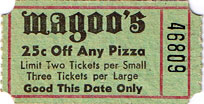
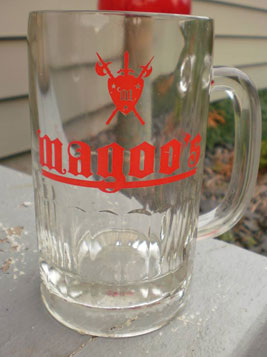
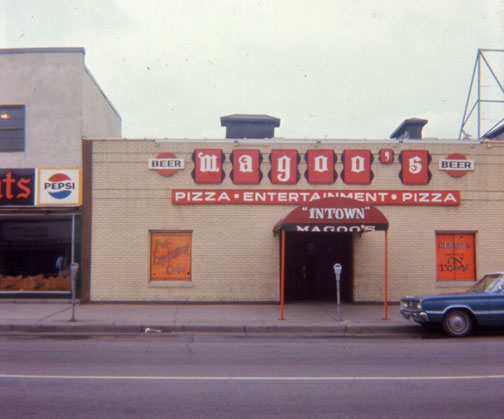
Photo courtesy Susan Shallman Anderson
MAGOO’S AND SONS
Magoo’s closed in May 1970; Will Jones reported that it had gone through a number of changes, suffered a shortage of business, and the owner decided to concentrate on the New City Opera House, “the rock dancehall that continues to bang away next door under the same management.”
Magoo’s refused to die, though, and had another life as Magoo’s and Sons. In June, four friends who had worked there made a deal with owner Roosen to operate it at their own expense and give Roosen a percentage of the receipts. The new proprietors were:
- Keith Smile, 19, a U of M student and head pizza cook
- Randy Larsen, 16, student at Central High and – despite his age – described as having worked there for several years.
- Paul Young, 20, U of M student
- Tim Eaton, 21, the only one old enough to serve beer
The guys decided to turn the place into a venue for folk, blues, and jazz. They got rid of the strobe lights and replaced the big tables “that made it kind of like a barn” and made smaller tables themselves.
Performers included:
June 25, 1970: Lonnie Knight and Shannon Elliot. The venue was listed as Magoo’s and Sons Folk and Blues Club. This may be the show where Lonnie sang his song, “Banging One’s Head on the Moon.”
Poor Howard
The Argirs, a folk-and-blues group featuring “a talented young blonde on flute.”
August 21, 1970: Jerry Rau; venue listed as Magoo’s and Sons Blues, Folk and Jazz Club.
September 3, 1970: Open stage
Things were a little dicey in terms of audience: “One night Lonnie Knight worked for a $10 bill and a sandwich.” Moms brought in pies to sell, and they tried to create a coffeehouse type atmosphere, although they avoided the word. They couldn’t afford to restore the pizza offerings, but were optimistic. Unfortunately, the guys lost their entire $200 investment, but they gave it the old college/high school try.
CAFE EXTRA-ORDINAIRE
The Cafe Extra-Ordinaire, owned by Bobby and Doris Jackson, was a jazz club, originally located across the street at 2954 Nicollet Ave. It’s unclear when it first opened; one source would compute to January 1968, while another would indicate about January 1967. The first ad found is from January 1969.
An article in the December 1969 – January 1970 issue of Metanoia magazine reveals that Jackson was himself an accomplished jazz drummer. A house band included musicians such as Bobby Lyle, Morris Wilson, and Jim Bell.
The purpose of the club was posted on a sign on the door: “To create more respect for the jazz musician and to create an atmosphere favorable to increased public acceptance of true jazz as a great American art form.”
In January 1970, critic Allan Holbert described the original venue:
Inside the Cafe Extra-Ordinaire has an atmosphere not unlike those jazz clubs that thrived in New York’s Greenwich Village during the 1950s. The bizarre modernistic paintings on the walls and the geometric forms on the ceiling take on an eerie glow from the black fluorescent light.
The musicians perform in front of a floor-to-ceiling curtain of aluminum foil that reflects the changing colors of lights that are thrown on it during the hour-long sets.
The chairs are arranged in rows, auditorium style, and sprinkled among them are small tables to hold such coffees as “Cafe Capuccino Mocha” and “Cafe Ravel” or such exotic drinks as “One Step Beyond” and “A Crippled Wing,” which are prepared and served by Jackson’s wife, Doris … [The club did not have a beer or liquor license.]
Except for an occasional “Tell ’em Bobby,” or “Go baby,” the audience of 60 or so jazz buffs was quiet and attentive.
“I know we’re not going to get rich here. I just hope we can keep the place open. What we want to do is help people understand progressive jazz and provide some work for musicians. We got some great jazz musicians in this town. You know what they’re doing? They’re playing in the strip joints down on the avenue. They gotta eat.”
In February 1970, Star critic Peter Altman noted:
The un-selfconsciously interracial audience evinced a very different kind of informality than one sees at the Labor Temple’s rock concerts. Attire was truly come-as-you-are. There was no show, no irritability, no antagonism in the air, just as there was no need for police. All the vibrations were good, the atmosphere was cool.
The night he was there, the audience only numbered about 50, “yet the room was alive and seemed populated with good will.”
Shows at 2954 Nicollet included:
1969
January 7 – 31, 1969: Afro Jazz Quintet
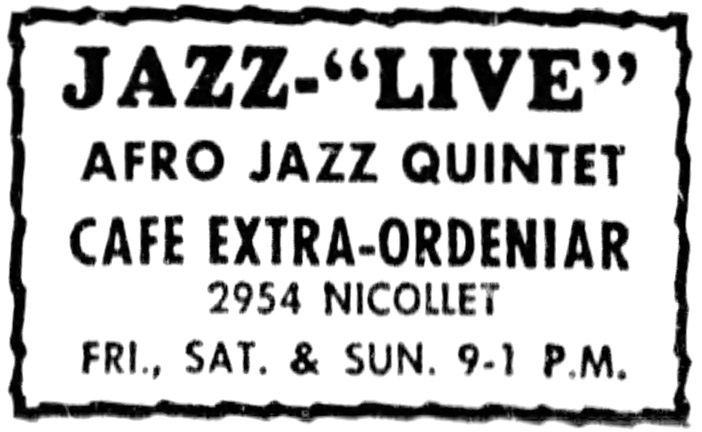
February 14 – 21, 1969: Gene Hubbard Quartet
June 23 – 29, 1969: Freddie Hubbard
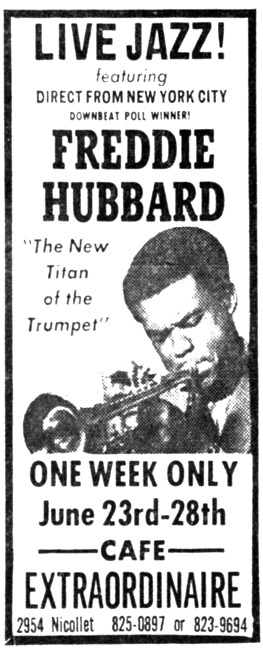
December 1969: Paul Arko Trio
1970
January 13 – 18, 1970: McCoy Tyner Trio
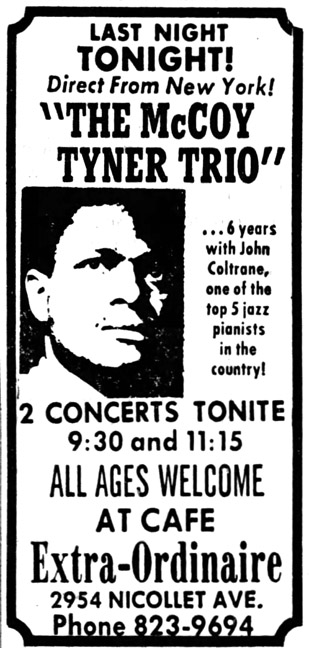
February 6 – 15, 1970: Sam Bevins Quartet
February 27, 1970: Pharoah Sanders Quartet
March 1970: Beau Baily Sextet
March 13 – 15, 1970: Bobby Lyle Quartet

March 31 – April 5, 1970: Elvin Jones Trio, with Joe Farrell on tenor sax and Wilbur Little on bass. Jones was billed as “the world’s greatest drummer.” The show got an excellent review in the Insider: “Here’s hoping Bob Jackson’s policy of importing national jazz groups will be continued; he does it for the music. His cafe is too small to make money.”
May 19 – 24, 1970: Rahsaan Roland Kirk. Star critic Peter Altman was blown away by the performance of Kirk, who played half a dozen wind instruments. Backing him up were Ron Burton on piano, Jimmy Madison on drums, Vernon Martin on bass, and Texidor on “soundtree (bells, rattles, and percussion devices”).
Kirk is a phenomenon who defies classification. He is a prodigy of energy, a marvel of invention, a master manipulator of moods, and a technical whirlwind. The average person would call his musical style modern jazz; Kirk prefers black classical music. Both terms are helpful, but neither hints at the circus virtuosity of Kirk’s performances … [The performance] stirred emotions up, ever ground them down; ignited, didn’t steamroll; made the audience yell and move, not sit subdued.
June 8 – 13, 1970: Mickey McLain Trio
September 14 – 19, 1970: Sid Farra Trio
Jazz Festival:
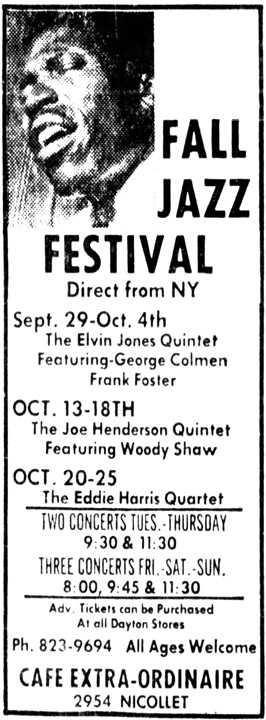
September 29 – October 4, 1970: Elvin Jones Quintet
October 13 – 18, 1970: Joe Henderson Quintet, with Henderson on tenor sax, Woody Shaw on trumpet, Lenny White on drums, Ron McClure on bass, and George Cables on electric piano. Star critic Peter Altman noted that the electric piano “at times sounds like a celesta, at other moments suggests a vibraharp … and adds a bright quality to a predominantly heavy sound.” Altman concluded his review with: “Much of the band’s appeal is attributable to the evident joy its members have in playing together. After taking a while to limber up, the quintet really got to swinging, rocking and wailing in the late hours.”
October 20 – 25, 1970: Eddie Harris Quartet
November 1 to 5, 1970: Kenny Burrell (not on the ad)
2933 Nicollet
In November 1970 the Cafe Extra-Ordinaire moved from their tiny club, where they had had some success presenting live jazz, to the much bigger Magoo’s building. Jackson leased the building with an option to buy. It was a big change; capacity grew from 101 to 800, and the lease came with a 3.2 beer license. The jazz shows continued; the house band was the Hubert Eaves Quartet.
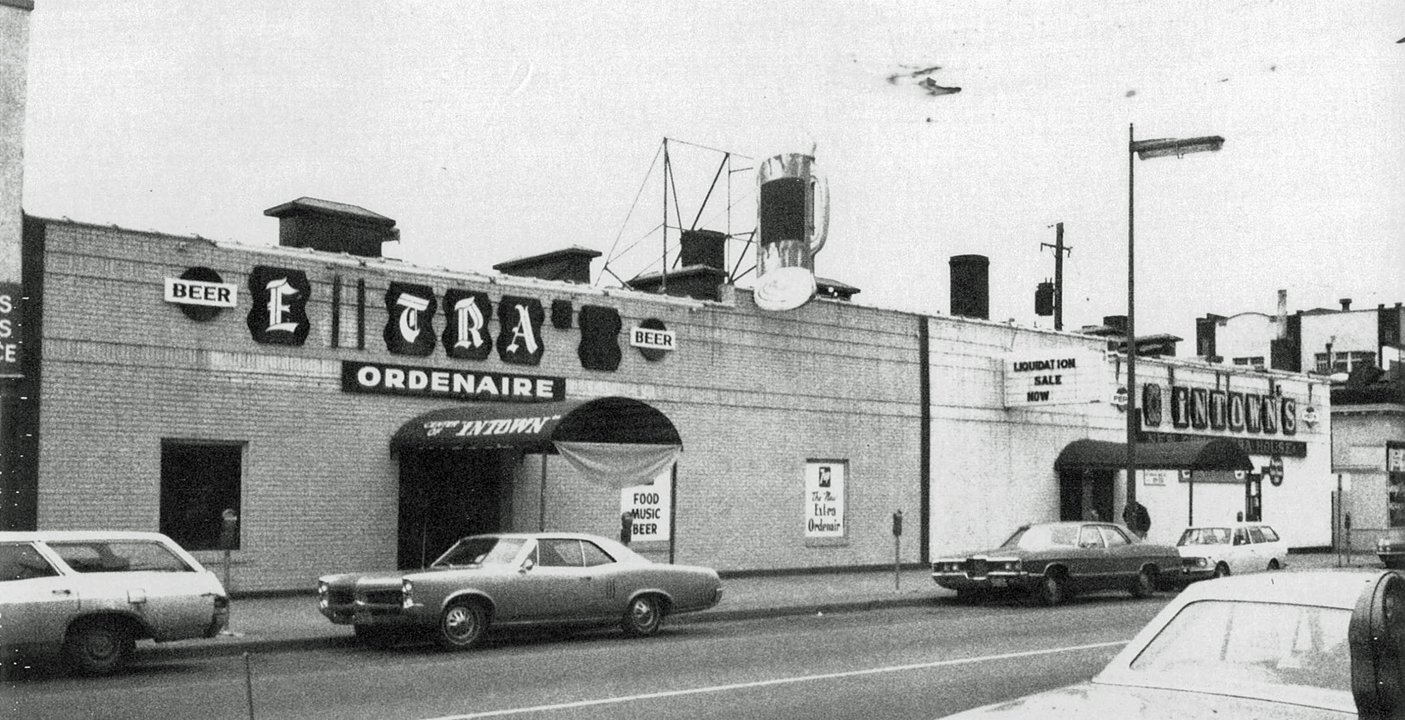
Photo courtesy Hennepin County Library
Peter Altman described the new digs:
The room is long and rectangular, and the bandstand is set up along one of the long sides, which might mean that if a crowd ever filled the place it would be hard to see well from the most distant tables. But sound carries well and there are surely more good, close seats now than there were before the relocation.
November 17 – 22, 1970: McCoy Tyner Quartet
December 8 – 12, 1970: Freddie Hubbard Quintet. Backing trumpet player Hubbard were Junior Cook on tenor and soprano saxophone, Louis Hayes on drums, Joe Bonner at the piano, and Mickey Bass on bass. Peter Altman reported a small audience on opening night.
December 15 – 20, 1970: Hubert Eaves Quintet. Photo below (with Magoo’s shield still on the wall) features Hubert Eaves, Joe Hill, Jerry Hubbard and Felix James.
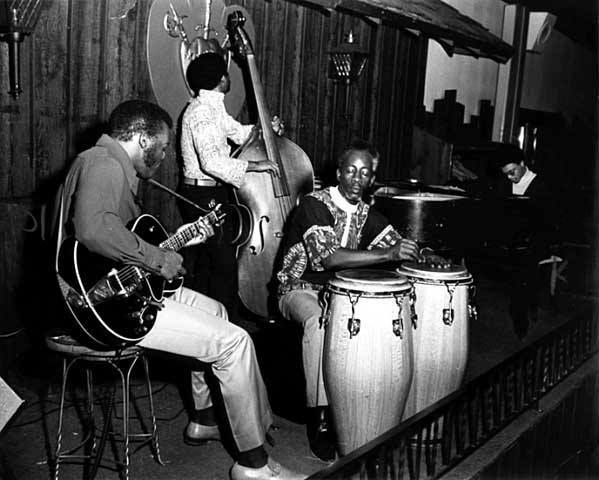
Photo courtesy Minnesota Historical Society
1971
January 5 – 10, 1971: Maurice MacInnis
January 20 – 24, 1971: Organist Richard “Grove” Holmes
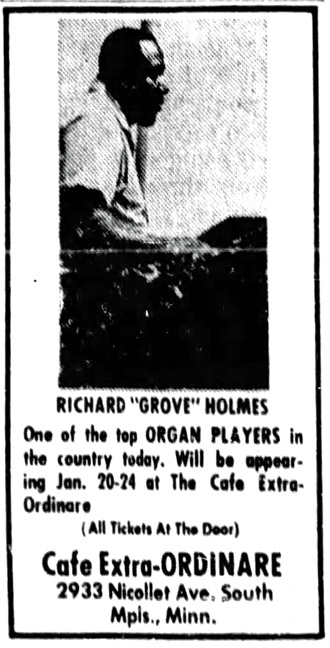
January 26 – 31, 1971: Pianist McCoy Tyner
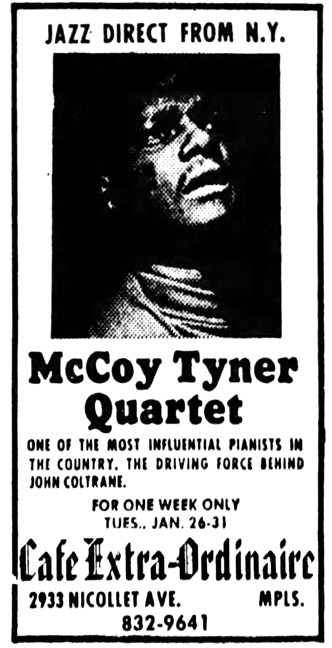
February 2, 16: Lamont Cranston Blues Quartet
THE FAUX BUDDY MILES FIASCO
The Jacksons booked Buddy Miles to appear on April 10, 1971. An article promised sidemen Andrew Lewis on clarinet and organ, Marlo Henderson on guitar, Charlie Karp on lead guitar, Dave Hull on bass, Tom Hall on trumpet, Hank Redd on tenor sax, Mike Fugate on trumpet, and Stemsy Hunter on sax.
But things went awry. Tom Behr shared the story on Facebook:
[My] brother Bob was an agent and the club owner asked him to book Buddy Miles. When Miles’ agent said he’d need a deposit to lock the date in, the club owner told Bob that he would take over the negotiations and send in the deposit. Then Bob was told that Buddy would be coming without the Express Band, so Jr. Trejo’s Saxon Soul was asked to sit in as Buddy’s back up band.
Here’s where the story gets better: Jr. said they had a rehearsal the afternoon of the show and Buddy played drums, but asked Jr.’s singer to sing his songs because he had laryngitis.
The crowd was beginning to sense there was scam going on. [Apparently someone recognized the keyboard player’s B3, which was covered with a blanket, and that’s when people realized something was up.] On the first break Jr. told the club owner that he finally figured out this guy was a sham and they were going to pull the plug on the show. [Jackson] said, “You better play or the crowd will trash the club not to mention your equipment!” Then he says “Hey Jr. can you play something by Chicago?” (I’m serious)
So as soon as they start to play the second set, people where booing, and throwing food, then drinks at the band, one by one the guys get off the stage, leaving “Buddy” to play a drum solo. Now as the riot is on, fake Buddy jumps off the drums, tosses off his Afro wig and out the back door he ran. The epilogue gets better: the Trib had a picture on the front page of the wig sitting on a table with a bunch of beer mugs, and it turned out the fake Buddy Miles was the janitor at Sacred Heart Church on the East side. I’m still laughing at that one!!
Marshall Fine was suspicious; in his review of April 12 he noted that:
- “Miles” was obviously wearing an Afro wig.
- Miles was fatter than “Miles.”
- Miles has a huge ego, but “Miles” stayed in the background in a dark stage.
- “Miles” only sang backup, while at a previous Labor Temple show, Miles “dominated his group with his thin voice, heavy-handed mannerisms and tiresome drumming.”
- “Miles” “did a drum solo at the end that was superior to anything Buddy Miles has done.”
From the Minneapolis Tribune, April 12, 1970 (Terry Farrell):
Youths rip club during disturbance
About 1,000 young people went to the New Cafe Extraordinaire late Saturday to hear black drummer-singer Buddy Miles and got “ripped off,” youthese for “taken.”
So, some of them decided to rip off the Cafe Extraordinaire, 2933 Nicollet Av. And they did.
They smashed the plush music club’s interior stained-glass windows, overturned and smashed tables, damaged some of the band’s equipment, emptied a fire extinguisher on a rug, tore open cash registers and a cigarette machine, broke a plate glass window, hurled glass mugs about the room, and then pushed out onto Nicollet Av.
Police were called about midnight, shortly after the eruption began. Squad cars quickly blocked off that portion of Nicollet. Policemen began to disperse the crowds and about an hour after the disturbance began it was all over.
It began when the predominantly black crowd realized that the performer who claimed to be Miles was an impersonator. And each of them had paid $5 a ticket.
Club owner Bobby Jackson, sitting amidst the ruins of the club, Sunday said he is not “at liberty to say what went on” concerning the impersonation. But, he added, “all responsibility should lie with the real Buddy Miles. A contract was signed with him.”
Jackson, in good spirits despite the loss of a night’s sleep and what he estimated to be $50,000 in damage to his two clubs (the New City Opera House adjoins the Extraordinaire) said “somebody slipped along the line.”
He said he did not think that his insurance would cover the damage to the clubs, valued at $1450,000. “There’s no way we can reopen.”
Jackson, 29 and black, said he “would go back to playing drums for $100 a week.”
He said that when the incident began he “split – there was no reason to stay.” He said he grabbed money from two cash registers and went home.
Soon after Jackson left, the police arrived. For the most part, though at times, gruff, they were restrained and efficient in dispersing the crowds. However, at least one incident did occur.
About six policemen led by an officer and with a police dog, crossed from in front of the clubs to the west side of Nicollet Av.
The officer, billy club extended, shouted to the people who lined the sidewalk to “move it. Go on, get out of here. One black man did not move fast enough. The officer kicked him in the groin, and he was picked up off the sidewalk by two other policemen to a squad car. Another man was also arrested.
No injuries were reported by police. The two men were arrested on charges of breach of the peace, failure to obey an officer and obscenity in public, police said.
Marshall Fine shed more light on the situation on April 15, revealing that the back-up band was called Saxon, led by Gary Winkler. The band had been hired to back Miles, and worked hard to learn the material. They met “Miles” just before the show, and noticed that “He was too skinny, and his hair looked fake.” Then Winkler was told that Miles had laryngitis, and that he’d have to sing all his numbers. Winker reported that when he realized the hoax, “I was embarrassed, man, like really ashamed. It got to the point where I was signing with my back to audience, I was so ashamed.”
It was after the second set started that the crowd turned. “Miles” hit the back door, and owner Jackson hit another door with $7,500 to $10,000 of the ticket money. Neither “Miles” nor Saxon got all the money they were promised. KUXL disc jockey Jimmy Smith, who had emcee’d the show, told Fine that he looked for Jackson, but his apartment had been cleared out and his phone cut off. This turned out not to be true; a subsequent article says that he had come to the police station and given a statement. He told police that when the hoax was discovered he had started refunding money, but was overcome by the crowd and left.
Another article by the Tribune’s Howard Erickson gave this as Jackson’s account:
Although some patrons became upset at what they considered deception and demanded their money back, “most of the people were satisfied, I think.” He said refunds were being made at the box office when “two, maybe three guys started making a big scene. One of them threw a beer bottle through a stained-glass window, hollered ‘Phoney,’ and fired a pistol. That got the whole audience panicky. The band left the stage and everybody else headed for the exits, fast. That’s what produced the damage – most of it was accidental from the crowd’s haste.”
Apparently the real Miles had been in town, but when he didn’t get the front money he was promised, he cancelled and went back to Boston, where he was during the whole thing.
The event was reported in Rolling Stone on May 13, 1971, in an article rather harshly entitled “You’re Not Buddy Miles, You Pig.” The last paragraph reads:
The real Buddy was not available for real comment, but his company, Mercury, claimed that Miles’ manager cancelled out of the gig the day before because Jackson had come up with only $500 of the $1500 deposit required by the contract.
PERRY PEOPLES
Regardless of whether he also worked as a church janitor, the imposter was actually an accomplished local drummer. Perry Carson Peoples, Sr., 40, had been performing around town for decades – one note said he played for the Stan Haugesag Orchestra for many years. In 1958 he led his Interpreters of Jazz at St. Paul’s Red Feather. Members of the combo included Hensley Hill on flugelhorn, Woodson Bush on alto, Irv Williams on tenor, Tim O’Donnell at the piano, David Facen, bass, Ira Pettiford. The group also presented a concert in 1958 at Macalester College. In 1963 Peoples was in Irv William’s Quartet.
Peoples was born in Kansas in 1928, one of nine children. In 1940 the family was living at 706 Rondo Street in St. Paul, and his father was a singer, employed under a WPA project. Three of his sisters were maids. The family had apparently moved to Minnesota in about 1935.
Although an article on Peoples identified him as a professional musician for 25 years, it also quoted him as saying he was the chief engineer at a St. Paul “institution” which he did not identify. In 1972 he was working as the maintenance manager at Crystler City (6800 Wayzata Blvd. in Golden Valley, now the site of Menard’s). But he was back working in music in 1978-1980. References to Perry, Sr. end in 1989 with a letter to the editor indicating that he now lived in North Minneapolis. He died on January 16, 2003.
Both Marshall Fine and Terry Farrell reported that Peoples said that he did not know that he was impersonating Miles and that Jackson had hired him to play “on my own merits.”
END OF THE EXTRA-ORDINAIRE
The incident was investigated by police, and detectives had taken the matter to the county attorney’s office for review, but the it was found that “There wasn’t sufficient evidence for us to prove a felony by any particular individual.” Dayton’s refunded money to those who had bought their tickets there.
However, although no criminal charges were brought, the Minneapolis license inspector recommended that the City Council revoke Jackson’s beer license. And as it turned out, Jackson lost his liquor license for a bad check. Jackson had paid for his license renewal with a check for $650, which bounced. He came back and was able to pay $300 on acccount, and was told to pay the other $350 on April 12, but when he came back to pay the balance, he was refused. When he asked for the original $300 back, the treasurer’s office refused to give it to him. Alderman Robert Denny told him that he “was lucky to get out with that,” and that if the whole $650 had been good, he would have probably lost that “for other reasons,” meaning the riot. As Jackson left the committee room, he was heard to say, “They’re all a bunch of liars in there, man.”
CODA
One of the men arrested on the night of the riot was Oscar Thomas Govan. He was found guilty of making inflammatory statements when the police were clearing the area. Officers testified that he had shouted things like “Kill the pigs,” “Burn the squad cars,” and “Get bricks.” Tribune reporter Terry Farrell (see above) testified that Govan had been kicked in the groin by a police officer and knocked to the ground during the arrest, but the judge said that that was irrelevant. (Govan, a Marine who was wounded by a land mine in Vietnam, received 100 percent disability payments.) He received a suspended sentence of 30 days in the workhouse. Govan died in 1988 at the age of 40.
The riot was the end of the line and the music officially died. All fixtures of the building were sold in November 1971.
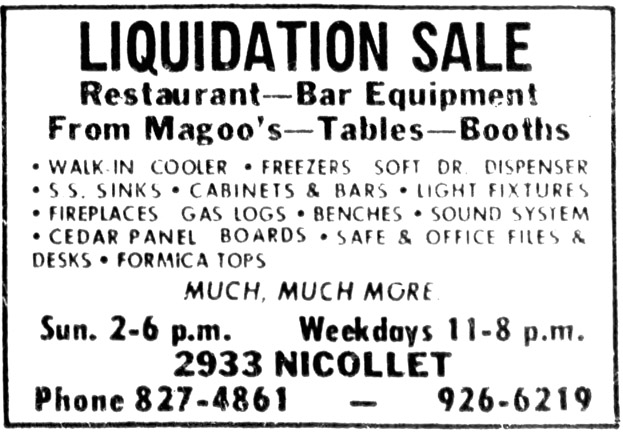
MAGOO’S TABLE TENNIS CLUB
An interesting postscript is that Magoo’s had apparently become a table tennis venue, and on December 12, 1971, the club moved to new quarters at 1516 E. Lake Street. The club featured 12 tables, balconies for spectators, and a pro shop.
RETAIL STORE
Starting in March 1972 the building was altered to be a retail store, according to permit records. No idea what that was.
DEMOLITION
The building that had hosted so much local music throughout the years was torn down in March 1977. There’s a rumor that the floor was used at a music or ballet school? The City of Minneapolis owns the property, which is leased to K-Mart. Nicollet Ave. was completely cut off in the process.
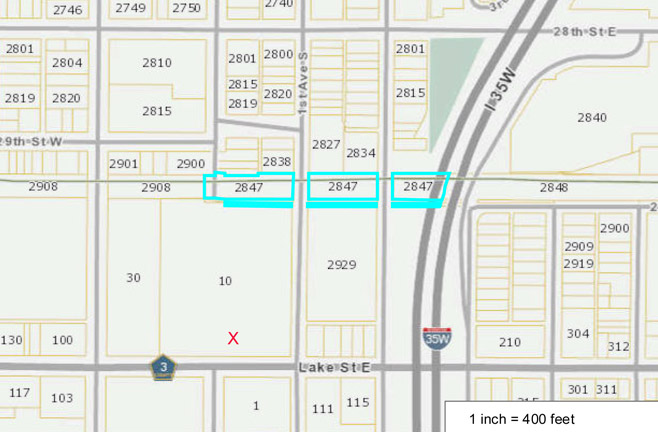
X Marks the spot of Mr. Lucky’s.
Save
Save
Save
This venue is located at 788 Grand Ave., 5 blocks east of Lexington, in St. Paul.
TALLY’S BAR
According to an article Dated June 25, 1948, Chester C. Tallaksen built the building in the summer of 1947 as Tally’s Bar. On June 16, 1948, a sheriff’s sale was ordered against the bar in order to pay a $23,959 claim by Dunnigan Construction Co. and $15,000 in other liens.
VOGES
On June 25, 1948, Tallaksen’s liquor license was transferred to Harold H. Voges, who was a sporting goods salesman and a well-known bowler who was in the newspapers frequently for his bowling prowess. There is only one mention of Voges in the Minneapolis papers other than Harold himself, and it was in 1949, referring to the Voges Cafe. The St. Paul papers are not online.
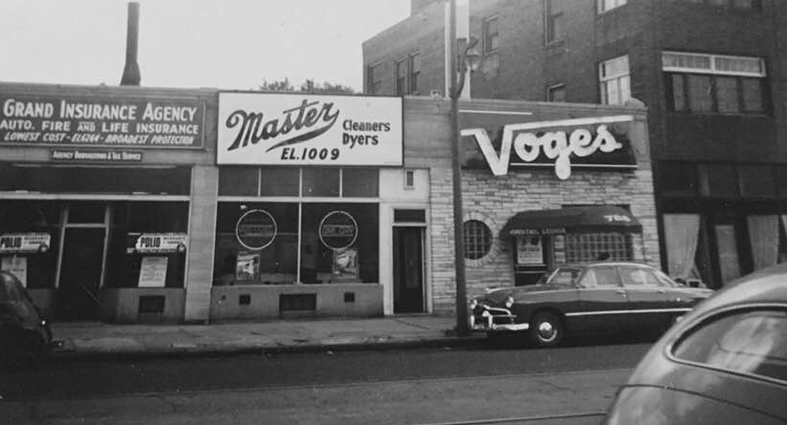
Photo courtesy Pam Ford
MR. PEDRO’S
Mr. Pedro was Joe Pedro, nee Pitera, from Calabria, Italy
In 1963, Mr. Pedro’s was described: Gracious decor with Tennessee marble, teakwood paneling and parquet floor for dinner dancing. Exquisite dining room chandelier. Dinner and dancing music nightly.

First ad, November 27, 1964
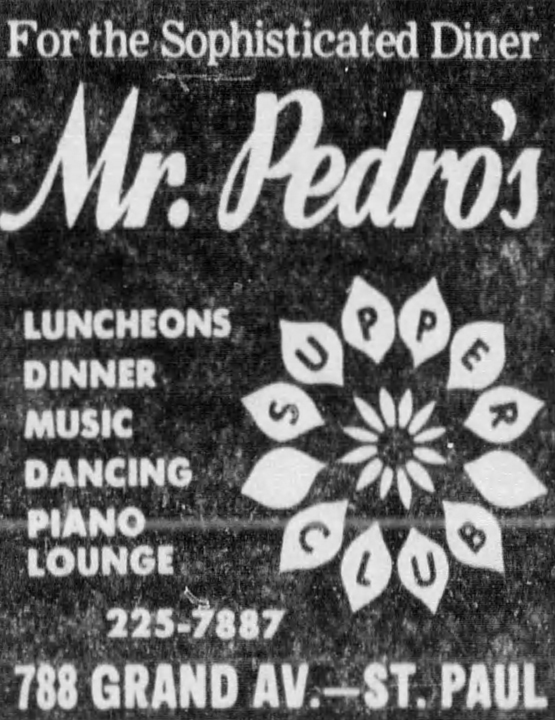
Minneapolis Tribune, February 26, 1965
Here’s a touching story from Rosemary Mueller Perreault, reprinted by permission from Facebook:
Went there with my fiancee to celebrate our wedding engagement in April of 1966. My fiancee was told he could not enter the restaurant without tie and sport coat. He was presented with a sport coat and tie to wear (the likes of a not particularly handsome Robert Hall ensemble), and we were escorted to a booth. After being totally embarrassed and laughing quietly to ourselves, we ordered our meal. Cannot recall the actual meal, but presumably delicious, we were serenaded by wandering violinists who stopped by each table and booth. To this day, it is a favorite tale to tell. The music was beautiful as I recall.
It was such a special occasion for us, celebrating our engagement. My fiance’s uncle joined us for dinner; he wore a sport coat! My fiance didn’t look like a scum bag. He wore a white shirt and dress pants; however, we were naive “kids” from small town Minnesota, did not realize the guy had to wear a sport coat to enter the restaurant. I, on the other hand, most assuredly wore a dress and high heels, which was the norm back then. Times have certainly changed and become more relaxed, possibly a bit too relaxed! I have no recollection what we ordered from the menu, as I believe I was too “star” struck with the violinists and just becoming engaged! It is a fun recollection.
Yes, our marriage survived the humiliating “no sport coat, no eating” rule at Mr. Pedro’s, and on July 2nd, 2018, we will celebrate 52 years of marriage!
From Dorene Peifer:
My step father died a year ago and I remember these glasses from when he and my Mother were married. So I kept the two he (they)carried around since the 1960s. Never did adjust the story. Assume it was s first date or favorite place to go.
Dorene sent a photo of one of the glasses from the ’60s.
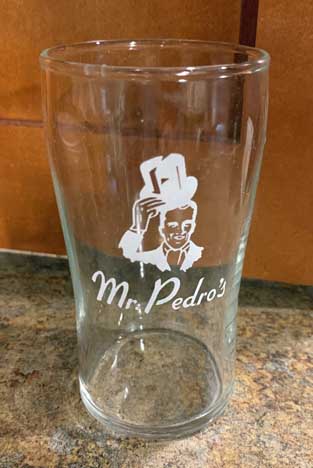
In 1970, the Roustabouts were the house band.
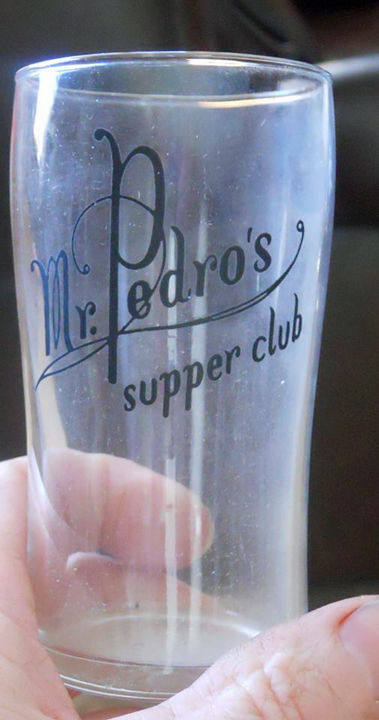
Courtesy Mark Youngblood
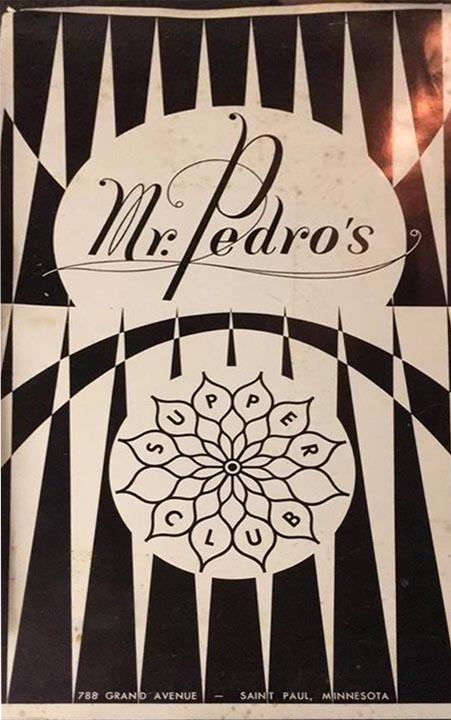
Menu courtesy Bryan Kruger’s Mom
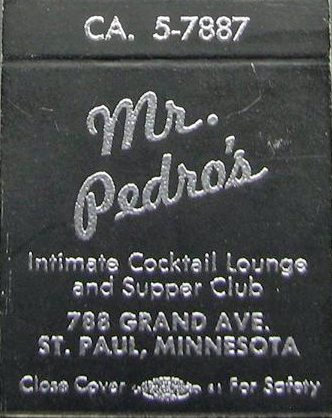
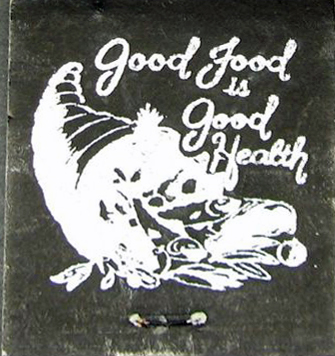
Matchbook posted by Ron Ciccone
The last ad in the Minneapolis papers was dated May 15, 1970.
NOBLE ROMAN
The location became the Noble Roman in January 1972.
The Noble Roman’s Chariot Room featured some of the best gimmicks in the Twin Cities. At first it appears that it was enough that the musicians in the bandstand looked like they were sitting in chariots.
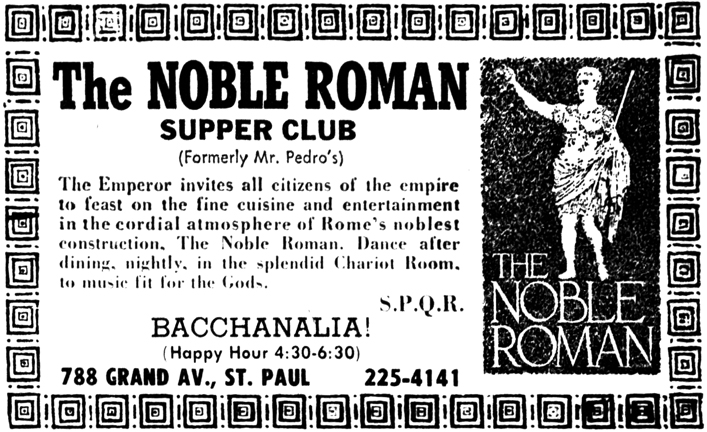
January 23, 1972
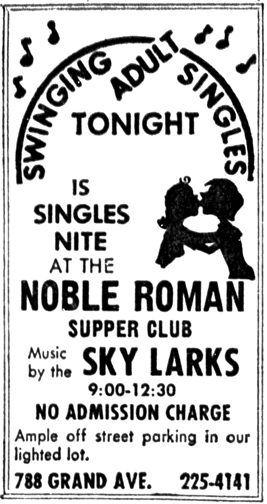
January 30, 1972
Fone-A-Fun
These ads were tacked on to various Singles nights ads at other venues, starting on June 2, 1972
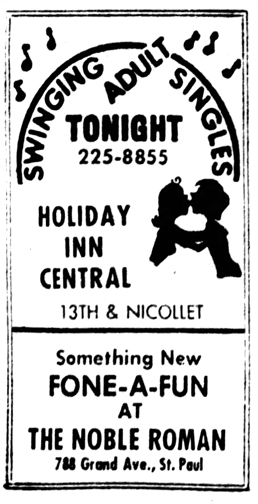
On June 24, 1972, Jim Klobuchar of the Minneapolis Star reported that the Chariot Room had been fitted with telephones at every table, so that patrons could call each other and chat or arrange for dances. Connections were made through a mini-skirted operator who sat behind the bandstand. The concept had started in a club in West Berlin, which Klobuchar had tried but had been foiled by the language barrier. It then traveled to San Francisco, but again Klobuchar had no ring-a-dingies, blaming it on his Vikings beanie. He was traveling with the team at the time, and the team was losing at the time. He figured he might have a chance at the Chariot Room, “assuming not all of the customers were under 30 and not all were reared in St. Paul.”
He was tipped off that a red-haired secretary from the First National Bank Building always dialed Station 36, so he sat there. Something about her Zodiac sign.
I was tastefully dressed in a style carefully intended to conceal any clues to my Iron Range breeding or Minneapolis background. I smiled easily, almost urbanely but not quite, avoiding a natural impulse to let all of the latent suaveness hang out.
Alas, his phone did not ring (actually a light flashed on a pole if you got a call), and it turned out that the redhead had dropped the Zodiac and took up Yoga. The operator took pity on him and gave him a call, giving him the time and temperature. “In our place, no customer is ever completely ignored.”
Phone-A-Fun was still in operation in October 1972 when Will Jones wrote a column about it. He didn’t have any luck either, but then again he sat at table 13.
The last mention of the Noble Roman in the Minneapolis papers was on December 25, 1973. It was reportedly a gay bar before it closed.
McCAFFERTY’S BAR AND RESTAURANT
Raymond McCafferty bought the place in 1976 and turned it into an Irish bar, with the accompanying Irish music and food. In August 1980 (or 1979) McCafferty sold the principal interest in the restaurant to three Irishmen, that is, men from Ireland. (or two Irishmen, Sean Clearkin and John Logan. McCafferty ran a gift shop in the basement of the complex called McCafferty’s Irish Village. (Minneapolis Star, November 6, 1981)
GRAND CENTRAL NIGHT CLUB
An article in the Star and Tribune dated June 20, 1986, by R.T. Rybak mentions that McCafferty’s was turned into a disco named Grand Central three years ago, which would be 1983.
LYON’s PUB
Lyon’s Pub on Grand (March 1991 to May 1997). This was a second location of Lyon’s Pub that was located at 16 So. 6th Street in Downtown Minneapolis from 1984 to at least November 2011.
WILD ONION
Wild Onion (May 1997 to March 31, 2018) Owned by Jay Salmen, former CEO of Sun Country Airlines
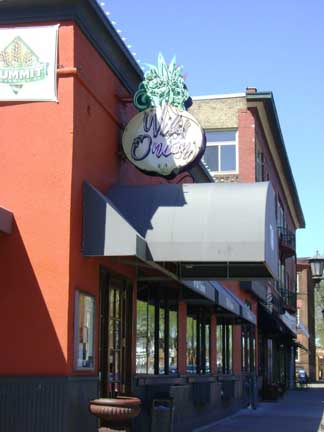
RED RABBIT
Owned by husband and wife Luke Shimp and Tracy Bachul, owners of the Red Cow restaurants. Red Rabbit is an Italian restaurant.
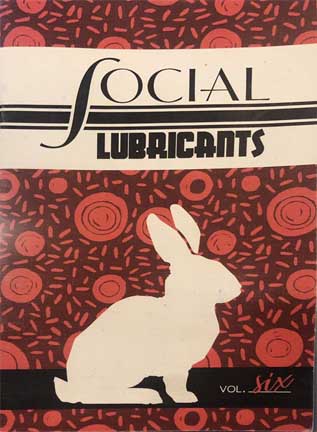
Save
719 Hennepin Ave., Minneapolis. 1948 ad promises “Delightful entertainment and choice of fine wines. Typical Chinese dinners prepared in our stainless steel kitchen.” Apparently a fixture for decades; photo below from 1910, Minnesota Historical Society.
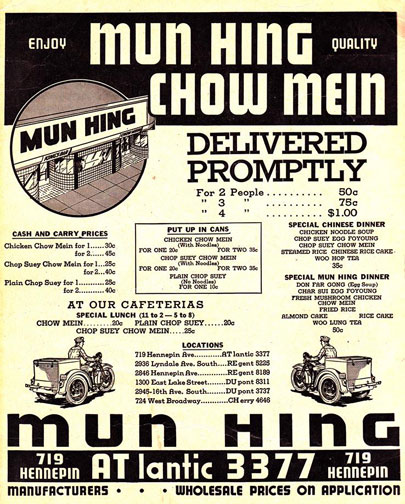
Please See Valley House.
This is a complicated tale of a family, a restaurant, two names, and three locations. I’ll do this by location.
2209 WEST BROADWAY
Arthur and Marie Murray opened the Red Feather Cafe on August 10, 1935, at 2209 West Broadway Ave. in North Minneapolis. (Their website now says it was in 1933)
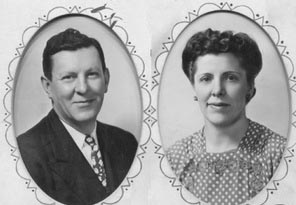
Art and Marie Murray
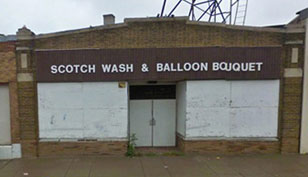
Original Red Feather – since torn down due to tornado damage.
18 SOUTH 4th STREET
In 1939 the Murrays moved the Red Feather to the Russell Hotel, 18 South 4th Street at Hennepin Ave.
In 1947 Carl A. Rees transferred the license to brothers and former U of M football players, Allen “Tuck” and Alvin J. “Nip” Teeter.
In August 1949, the licensee was Mrs. Allen Teeter, wife of former U of M football player Tuck Teeter. She took over from her husband Tuck and his brother Alvin J. (Nip) Teeter.
In November 1949, Mrs. Teeter asked to move her license to 415 Hennepin Ave. to start a bar with no food. The name would tentatively be called the 415 Bar. It would become the notorious Saddle Bar. (Minneapolis Tribune, November 10, 1949)
RED FEATHER CAFE
The Red Feather remained in place featured jazz in the 1940s and ’50s; in 1952 Bobby James and His Band, with Lois Christy, performed there. In February 1952 it was owned by Aleck Ostrow. At that time the question of whether taxes had been paid on the license were asked and people were accused of perjury and more.
26 SOUTH SIXTH STREET
In 1945 the Murrays purchased the building at 26 So. Sixth Street and on August 5, 1946, they opened Murray’s Restaurant and Cocktail Lounge. The building had been the home of Delayney’s Bar, the Winter Garden Ballroom, and the Hankow Cafe.
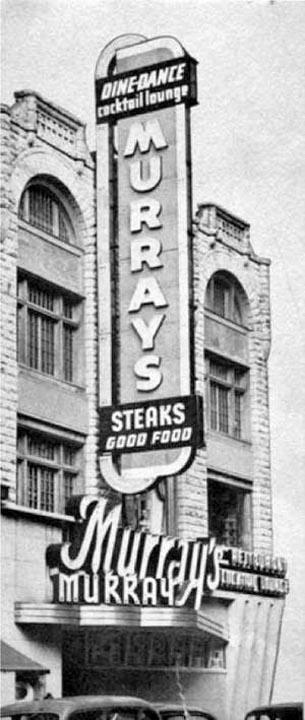
Murrays, 1946-1954
For comprehensive histories, click Here and Here.
1963: Dining and dancing in an atmosphere of elegance.
1969: Don Lee on organ, Rob Treber in piano lounge.
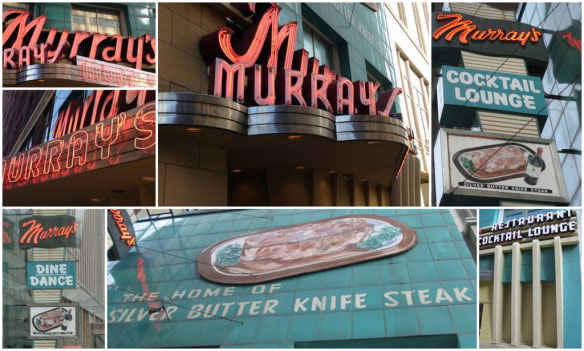
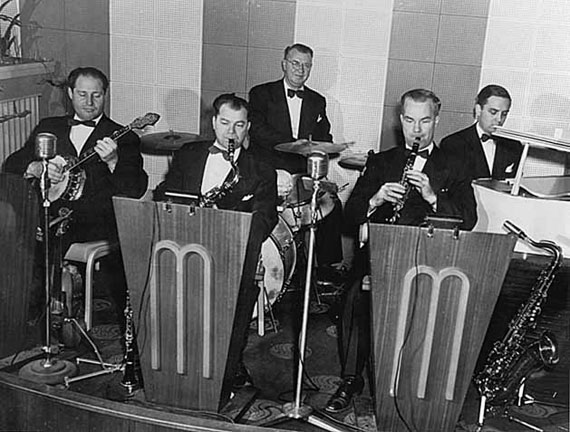
Murray’s Restaurant Band, 1949, courtesy Minnesota Historical Society
The Music Bar was located at 408 Cedar Ave. on the West Bank.
THE BUILDING
Minneapolis permits cards show work on 404 – 410 Cedar Ave. 408 was seldom specified by itself.
In September 1884 a 44′ by 90′ brick store with apartments above was built at a cost of $10,000.
A 25′ by 38′ additional brick store was built in 1909.
In 1911 a 50′ by 100′ brick store and theater was built for $6,000.
Uses of the building ran the gamut from barber shop, hat shop, theater, pool room, dry goods store, and in the 1920s it held the Enger Brothers Funeral Home. In 1920 the theater and pool room was converted into what became the Riverside Station Post Office. In 1935 there was a bank noted on the card.
ADOLPH’S BAR
In January 1934, Adolph G. Wall was granted a liquor license and all other necessary licenses to operate Adolph’s Bar at 408 Cedar Ave.
In August 1940, the City Council went on record that they would reject any application for a liquor license for 408 Cedar submitted by Coleman McDonough, because when McDonough made the application he was accompanied by Cliff Skelly. Skelly had been convicted in the Urschel kidnapping case and it was clear that he was going to be the boss, noted Alderman Kauth. (Minneapolis Star, August 30, 1940)
CEDAR AVENUE BAR AND LIQUOR STORE (408-410 CEDAR)
On January 15, 1946, a fire broke out that destroyed $40,000 of stock and sent two firemen to General Hospital with smoke inhalation. The fire was confined to the basement, and the damage was mostly to liquor bottles that had their labels and tax stamps washed off. Bob Henderson was listed in the news report as the manager. (Minneapolis Tribune, January 16, 1946)
Vincent J. Fabel, proprietor of the Cedar Avenue Bar, was arrested for selling liquor after hours on Sunday, May 25, 1947. He lost all of his licenses on June 27, 1947. Anthony B. Cassius applied for Fabel’s license for his place at 207 Third Street S. Cassius was blocked for several months by the City Council, but was finally approved on December 31, 1948, making him the first black bar owner to hold an on-sale liquor license in the City of Minneapolis.
Meanwhile, 408 Cedar had stood empty since June 27, 1947.
THE MUSIC BAR
On September 6, 1949, Louis D. Berenson applied to transfer the liquor license belonging to the Music Box Bar to 408 Cedar. The Music Box Bar, 246 Nicollet Ave., had burned to the ground on December 25, 1948. The liquor license belonged to Berenson’s uncle, Henry Berenson, who sold them to his nephew. The transfer was approved on October 1, 1949. Berenson also applied for a dance hall license, which the bar had not had before.
The first ad for the Music Bar was in February 1950, calling it Minneapolis’s newest.
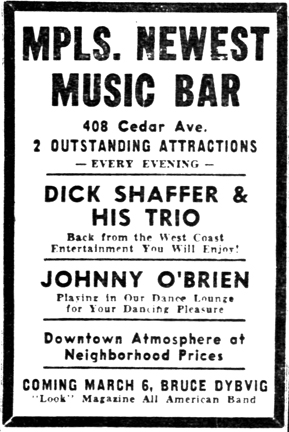
Minneapolis Tribune, February 25, 1950
The bar was advertised in the Minnesota Daily in 1952 (King Larry and His Jazz Combo)
In November 1952 the liquor license was transferred from Oscar Pearson, a salesman for Hamm Brewing Co., to Billy Miske, Jr. Miske’s father was a well-known heavyweight boxer.
The Minnesota Daily advertised Billy Miske’s Excellent Band in 1954.
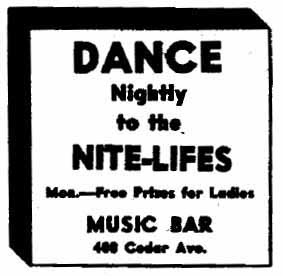
Undated ad from the Minnesota Daily, courtesy Robb Henry
In June 1954, the liquor license was transferred from Miske to Patrick J. Dooley.
Jan North played in an all-girls’ band called the Irene Brown Trio in 1955.
Nate Wexler, a musical comedian, performed at the Music Bar in June 1958.
Country Acts began to be advertised in 1961:
The Rainbow Valley Trio, August 1961
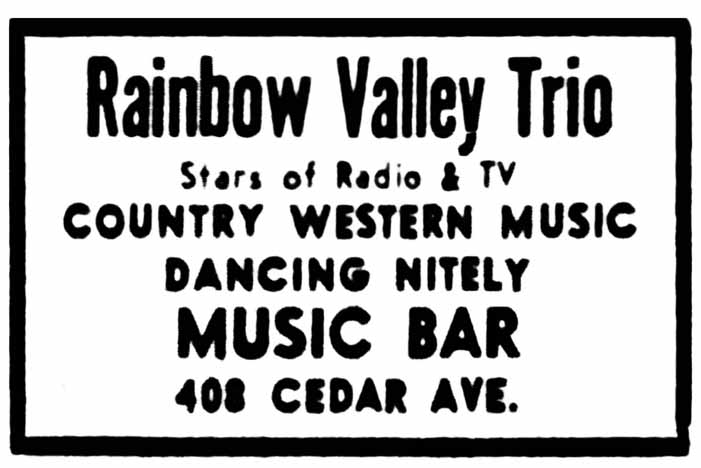
Minneapolis Tribune, July 31, 1961
Duane Carter and the Ramblers, September and October, 1961
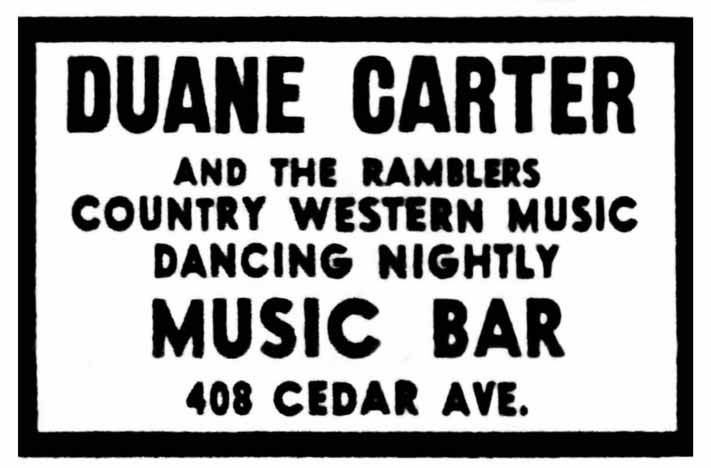
Minneapolis Tribune, September 27, 1961
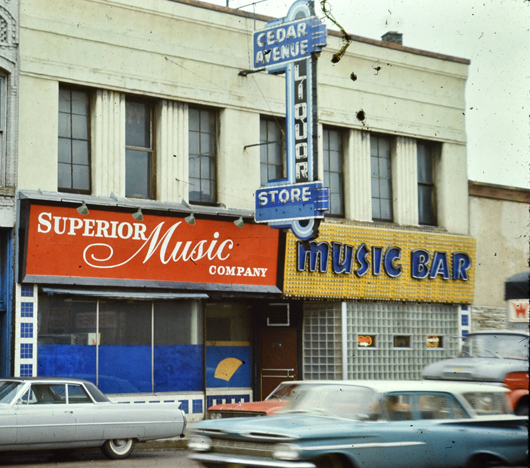
1966 photo courtesy Hennepin County Library
The Music Box was located at 246 Nicollet Ave., Minneapolis (next to the Nicollet Hotel).
An undated and unsigned memo (probably from the mid 1940s) says that the owner of record was the Nicollet Hotel but suspects that gangster Tommy Banks may have held the deed.
The holder of the liquor license was apparently Henry Berenson of the Minnesotan Hotel. (Minneapolis Tribune, September 7, 1949)
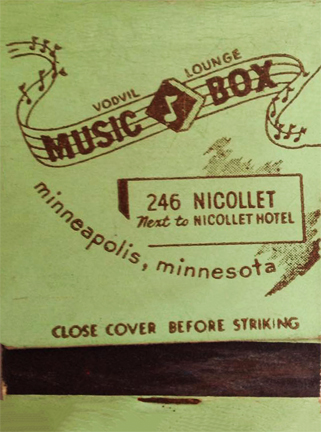
Matchbook images above and below courtesy Mark Youngblood
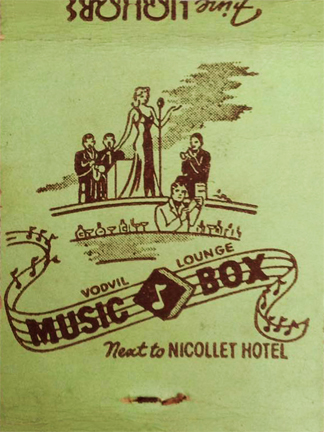
Stebbins: “During most of its existence from 1943 or 1944 to some time in the late 1940s it featured the same trio, the Mel Arvin band. In 1948 it also featured red hot Gypsy Edwards, Mel Arvin’s wife.
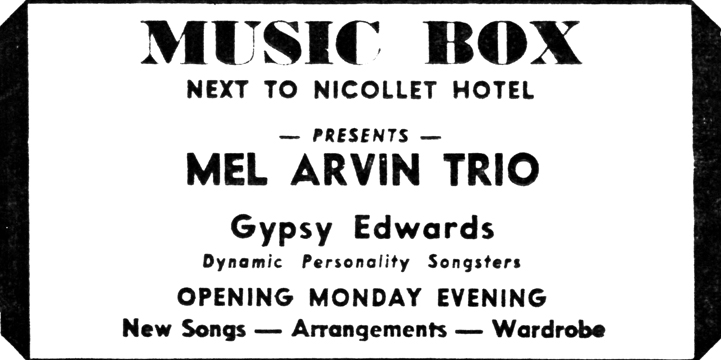
Minneapolis Star, July 25, 1948
In 1944 the Art Van Damme Trio also worked there.
FIRE
The building burned to the ground in a four-alarm fire on December 25, 1948. The story can be told in the captions of the pictures in the Minneapolis Tribune on December 26, 1948:
This is what the corner of Nicollet Avenue and Third Street looked like Saturday afternoon after firemen had checked the $500,000 four-alarm blaze. The fire broke out at 5 am in the Music Box bar, 246 Nicollet. Only a favorable wind prevented the flames from seriously damaging the Nicollet hotel… The icicle-covered building also houses the Wesley Trunk Co., Nicollet Bar B-Q, Nicollet Men’s shop, three dental offices and Chicago Dental laboratories.
Icicles Form Gruesome Winter Scene – Water from firemen’s hoses froze almost as fast as it spurted into the air in the six-below-zero temperature. Store fronts along Nicollet Avenue between the Nicollet Hotel and Third Street were hung with icicles. Firemen threw a tarpaulin over a parked car to safeguard it from water damage.
The tons of water poured on the flames at the Music Box bar Saturday morning tore down a half-block of Christmas decorations on Nicollet Avenue. Water from 22 fire trucks flooded the street and froze into a solid mass.
After the fire was put out, ice was holding up one of the walls, and it was ordered torn down for public safety for fear of falling on someone.
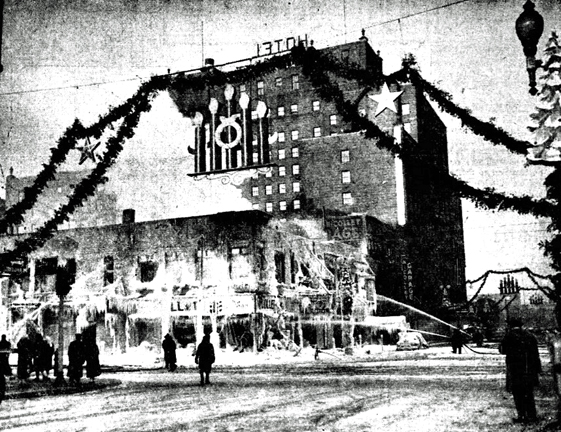
Minneapolis Tribune, December 26, 1948
The location became a parking lot for the adjacent Nicollet Hotel. The liquor and other licenses were transferred from Henry Berenson to his nephew, Louis D. Berenson, to run the former Cedar Ave. Bar, 408 Cedar Ave., which had lost its license for illegal activities. That bar on Cedar then became known as the Music Box Bar.
The Musicians’ Rest was in an old, large house at 141 Highland Ave., just off Sixth Ave. No. and Lyndale.
Myrt’s Café opened at 6325 Minnetonka Blvd. at Dakota in St. Louis Park in 1957, catering to the teen-age trade. It was run by Mr. and Mrs. Truman Hedwall. It created some controversy as to whether the police were enforcing the law (re: drinking, smoking, curfew) evenhandedly. Myrt’s didn’t last long, and Beek’s Pizza opened in the building in May 1958.
The Nacirema Club (American spelled backwards) was located at 3949 Fourth Ave. So. in Minneapolis. Tax records show that the building was built in 1934.
In an article in Minnesota History, Jackie Beckey reports that the club (sometimes called “The Nac”) opened in 1955. It was used for hosting community meetings, Christmas parties, and fashion shows. It was also a jazz venue – Stebbins reports that it was a jazz hotspot in 1964.
By 1967 it had 600 members, with A.B. Cassius as president.
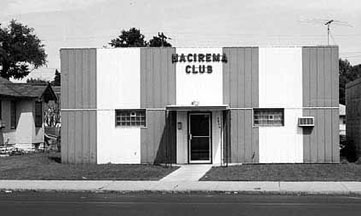
Nacirema Club, 1975. Photo Minnesota Historical Society
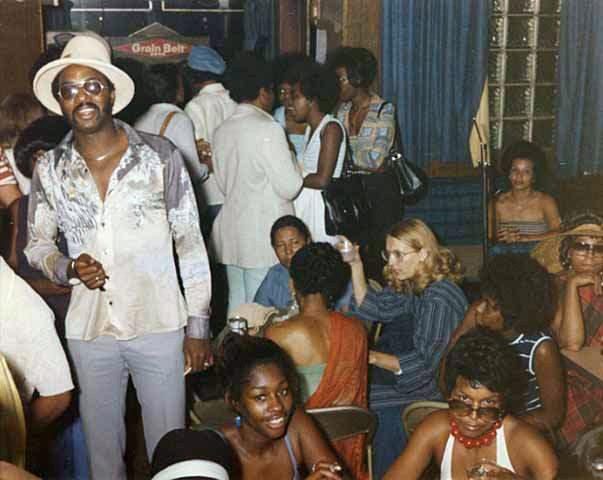
1980 photo by Charles Chambliss courtesy Minnesota Historical Society
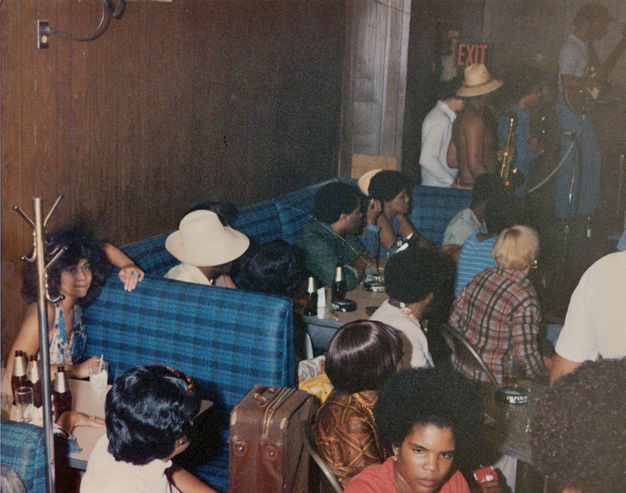
Photo by Charles Chambliss courtesy Minnesota Historical Society
As of 2018, the building was the El Bethel Baptist Church.
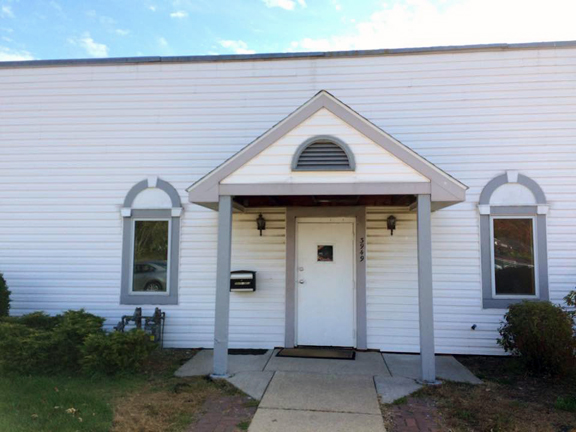
Nando’s Hideaway was located at 1975 E. Old Shakopee Road, in Bloomington.
Instead of a romantic night club, this was actually a picnic ground, located south of Old Shakopee Road and east of Cedar Ave.
Thanks to the folks on the Flashbacks of Bloomington, MN and Surrounding Area Facebook page, we learn many things about this place with the wonderful name!
Ed C. says there was a long driveway going down to it.
COSTELLO’S GROVE
Costello’s Grove was located at 92nd and Cedar (on the Minnesota River) and was operated by William S. Costello. The first mention of this location is on October 11, 1935. It was the site of the annual Boo-yah and Mulligan feast. (Minneapolis Journal)
It was the kind of place where an organization would rent it out for a picnic – like the butchers union, or a church, or a political organization.
Costello apparently did very well. On June 7, 1942, the renovation of his home, which was described as a farm house located near the Grove property was highlighted in the Minneapolis Sunday Tribune and Star Journal Magazine.
There was dancing – In June 1943 Costello placed three ads in the Minneapolis papers.
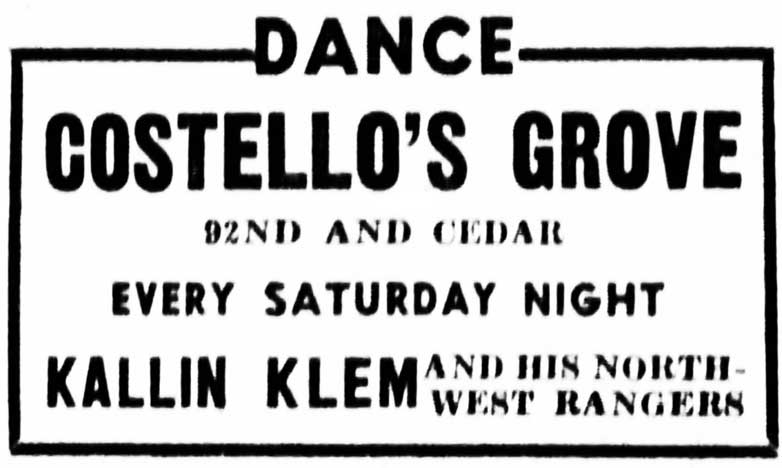
Minneapolis Star, June 12, 1943
However, in June 1944, Costello was fined $50 for allowing dancing after midnight, when a group of high school just-graduates were found dancing at 4:30 in the morning. By this time the venue was in Bloomington Township. (Minneapolis Star Journal, June 16, 1944)
McDONALD’S PICNIC GROUNDS
The Raymond McDonald family of 8233 Lyndale bought Costello’s and modernized it between 1950 and 1951.
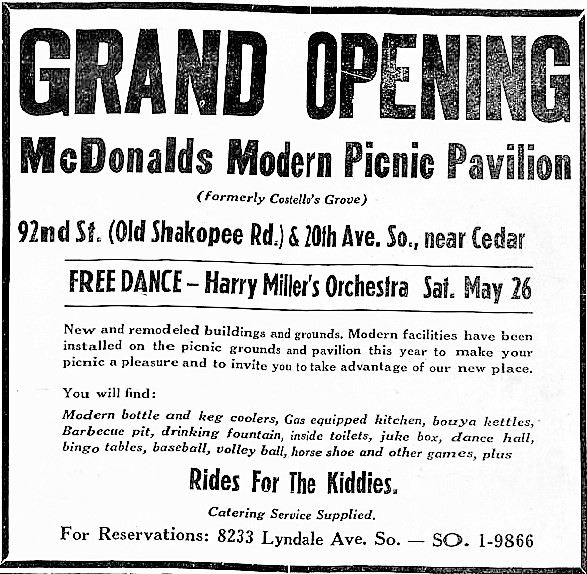
Bloomington News, May 17, 1951
NANDO’S HIDEAWAY
McDonald’s became Nando’s Hideaway in the spring of 1956, and featured dancing.
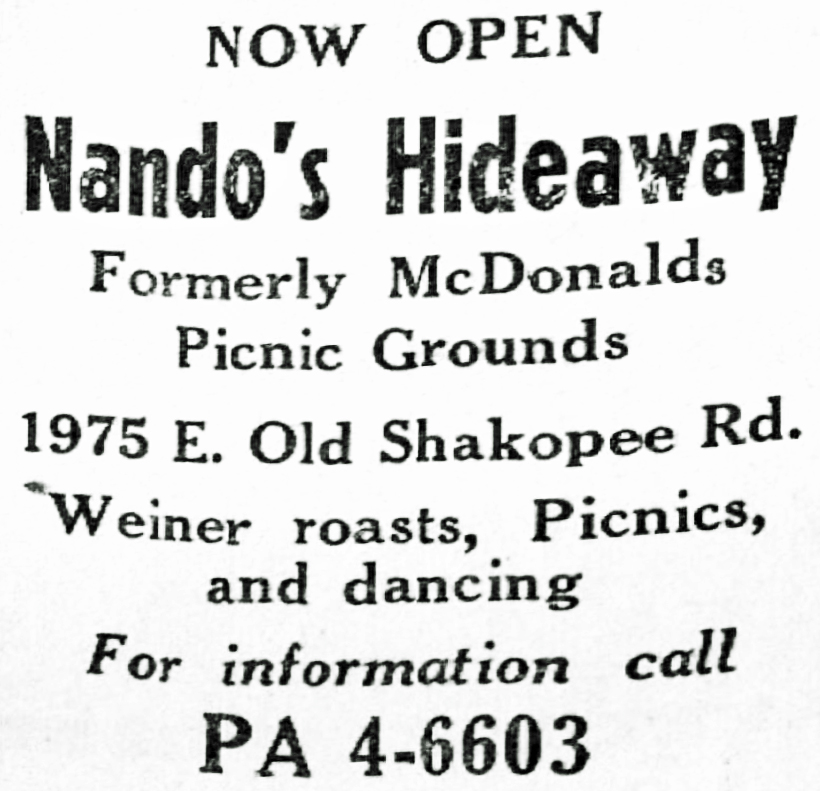
Bloomington News, May 1956
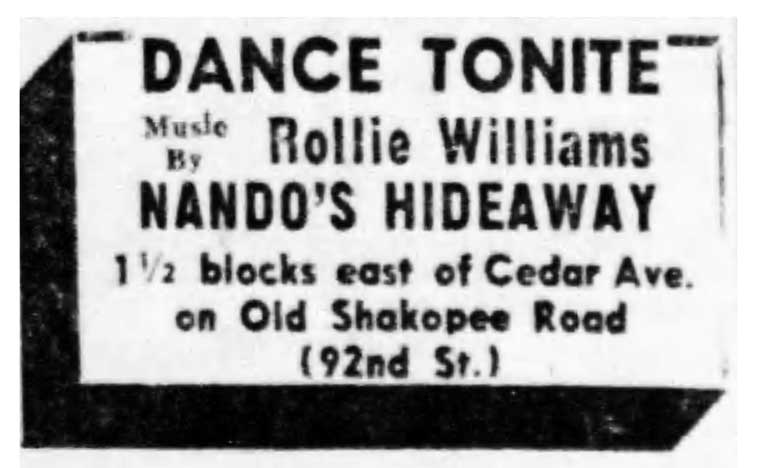
Minneapolis Tribune, June 23, 1956
In 1959, Nando’s Hideaway belonged to George Paytyn, who applied to the Bloomington City Council to replace the picnic pavilion with a trailer park. He pointed out that although the property was adjacent to a highly-restricted residential area, the park itself was zoned industrial. In the face of a petition with 140 names, and a recommendation of denial by the planning commission, the Council rejected the application. (Minneapolis Star, December 22, 1959)
HALL BROTHERS
In the spring of 1960, the place was taken over by Tom Snelling, a former air force sergeant who had run NCO clubs for 17 years. Snelling said that the place was called Nando’s because two of the women who operated the picnic grounds before were named Nancy and Dorothy.
Snelling transitioned the venue into a night club that featured the Hall Brothers Jazz Band on Friday and Saturday nights, although picnics were still held there.
Will Jones turned his attention to Nando’s in his Tribune column of August 16, 1960, thank goodness.
His physical description was:
Down a long, dusty lane into the woods, then into a clearing, then into the place itself, a big room with bare wood walls, burlap tacked to the rafters and kerosene lanterns for lights.
Ouch. Sounds like a fire waiting to happen.
And it did.
Terry B. says:
It burned down around 1961 or 1962. Now there is the CR 77 bridge that crosses over the original site of the place. I have been looking for along time for information about this place. I hope someone out there can shed some light on the history and the owners. I heard a long time ago that there were some Minneapolis wrestlers involved in the ownership or management of it.
Over email comes Denise, who says,
I grew up on Old Shakopee Rd across the street from the driveway to Nando’s Hideaway. The Brett family’s house was next to the driveway. I was childhood friends with the Brett kids and went to school with them. They told me there grandparents owned Nandos Hideaway. After it burned down we used to go play down there in the burned ruins.
Anyone know any other pieces of the Nando’s puzzle? Contact me!
The Nankin Cafe was a destination Chinese restaurant was located in three different places in downtown Minneapolis.
LOCATION 1: 15 SOUTH 7th STREET: 1919 – 1958
The Nankin first opened on October 23, 1919, at 15-17 South Seventh Street. The proprietor was Walter C. James.
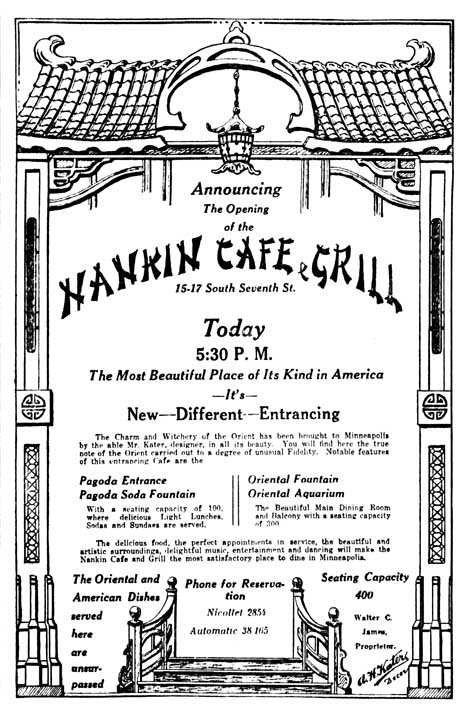
Minneapolis Tribune, October 23, 1919
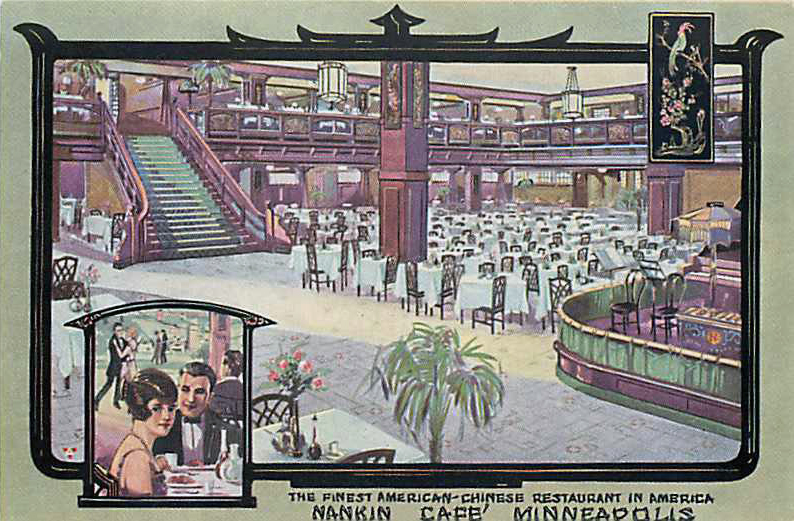
Postcard from the 1920s, courtesy Minnesota Historical Society
The Nankin Trio – the White Brothers and Stendal – performed over the radio on WBAD in 1922, along with Dick Long and his Original Jazz Band. Long led the house orchestra continued to broadcast over the radio into the 1940s.
There was a hall on the floor above where the Wolverine Club would hold dances.
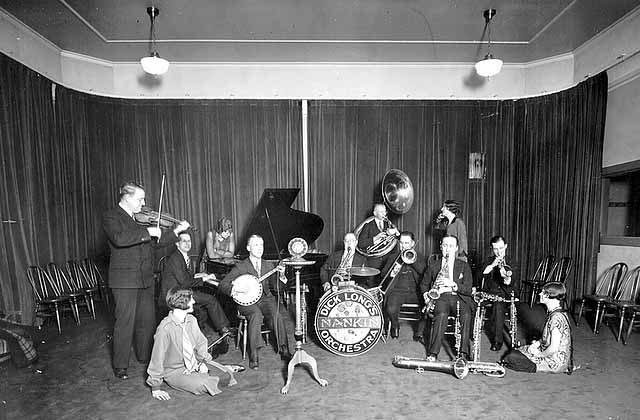
1924 Photo courtesy Minnesota Historical Society
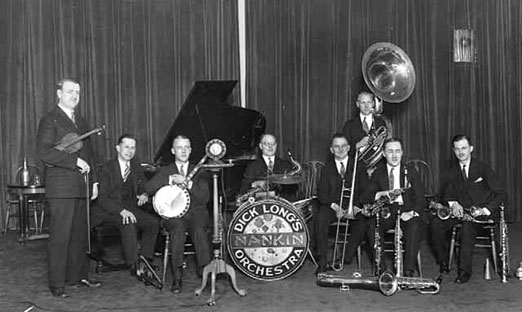
1925 photo courtesy Minnesota Historical Society
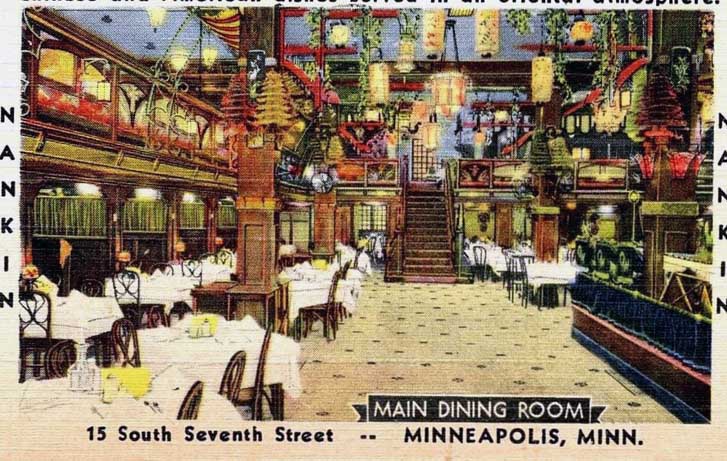
In 1949 James sold the Minneapolis Nankin to the Golden and Chalfen families, which also had interests in Holiday on Ice and the Minneapolis Lakers basketball team.
In late 1958 the Nankin moved across the street; the original location was razed for what was originally called the Dayton-Radisson parking ramp. The photo below shows what it looked like just before demolition by Rose Brothers Lumber Co.
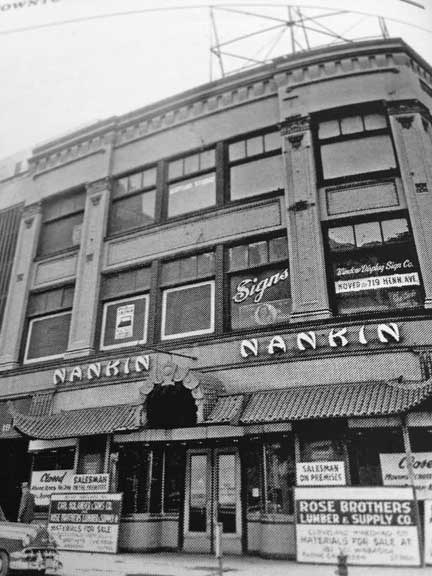
The original Minneapolis location. 1958 photo courtesy Minnesota Historical Society
ST. PAUL
The program below from the Metropolitan Opera House is dated January 13, 1924, and indicates that there was another Nankin, under the same management, located at the corner of 7th and Wabasha in St. Paul (420 Wabasha).
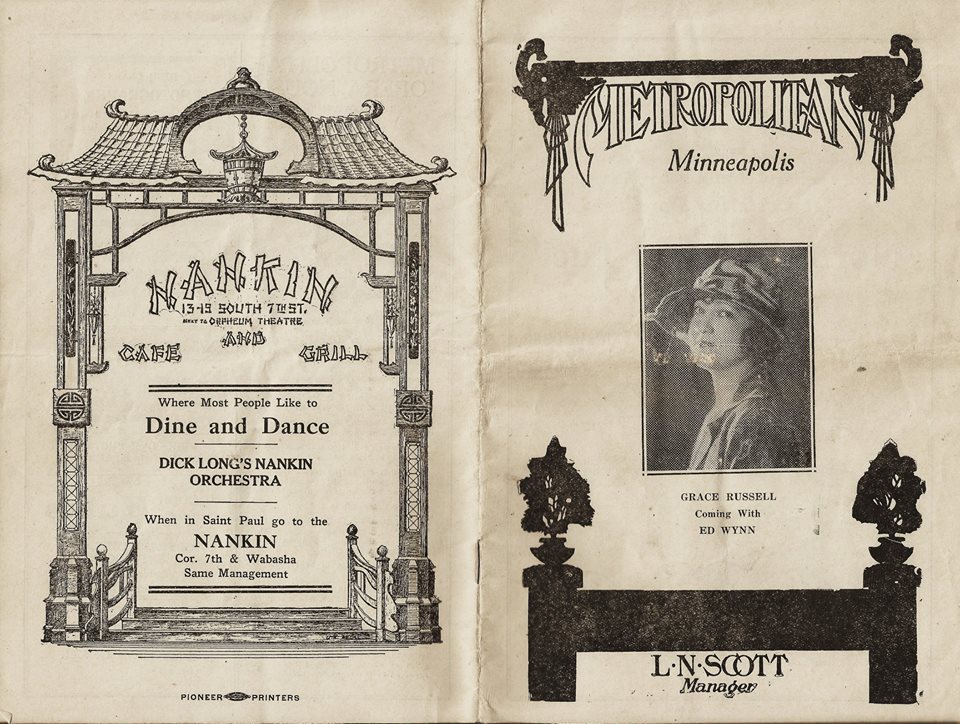
Courtesy Jeff Lonto
The restaurant is listed in the 1914 St. Paul directory at 420 Wabasha.
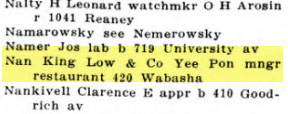
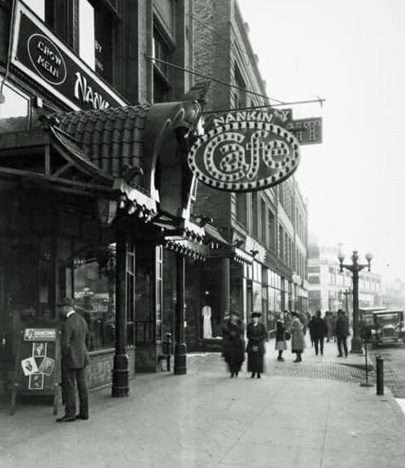
St. Paul location, October 2, 1920. Photo courtesy Minnesota Historical Society
CHICAGO
James opened another Nankin in downtown Chicago in 1933. It was managed by Walter James’ sister and brother-in-law, Lola and Joe James. That restaurant moved to Skokie in 1948.
MINNEAPOLIS LOCATION 2: 20 SOUTH 7th STREET: 1958 – 1980
The Nankin moved across the street to 20 So. 7th Street in late 1958. In 1931 this building had been Miller’s Cafeteria.
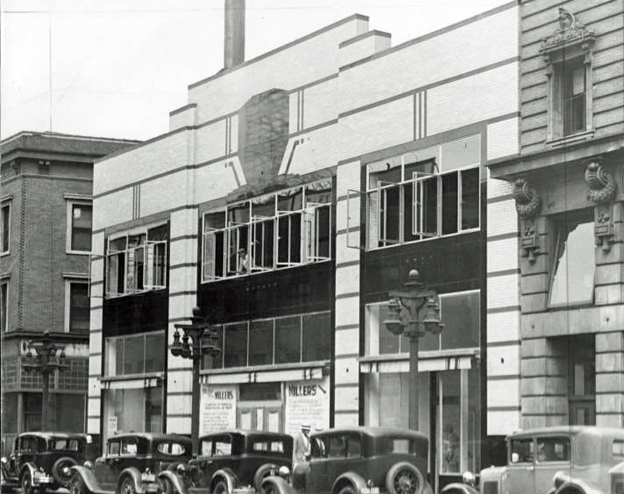
Miller’s Cafeteria, 20 So. 7, August 30, 1931. Photo courtesy Hennepin County Library
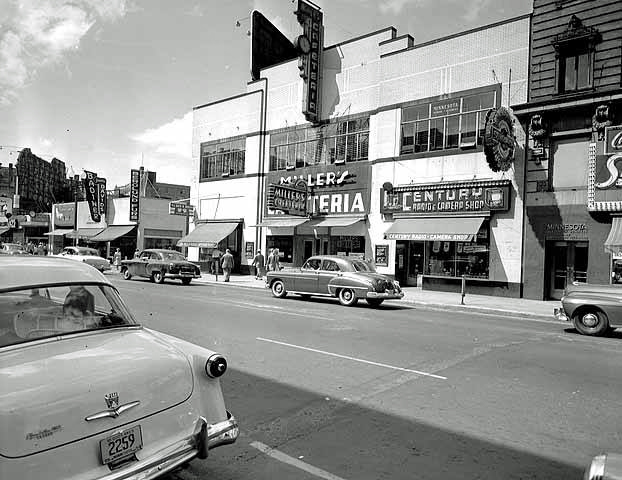
Miller’s Cafeteria, July 8, 1954. Photo courtesy Minnesota Historical Society
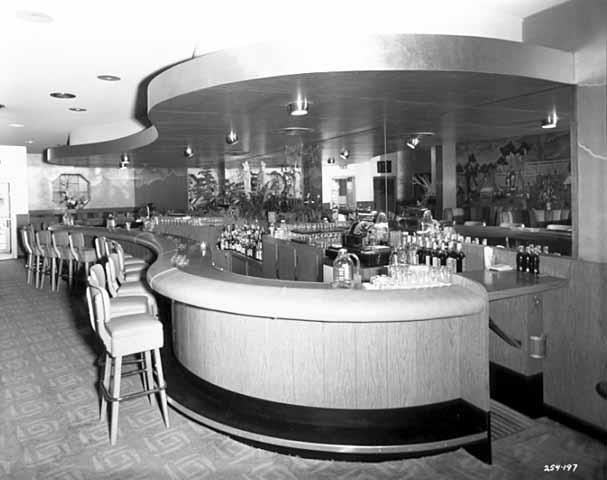
Nankin Bar, September 4, 1958 – Courtesy Minnesota Historical Society
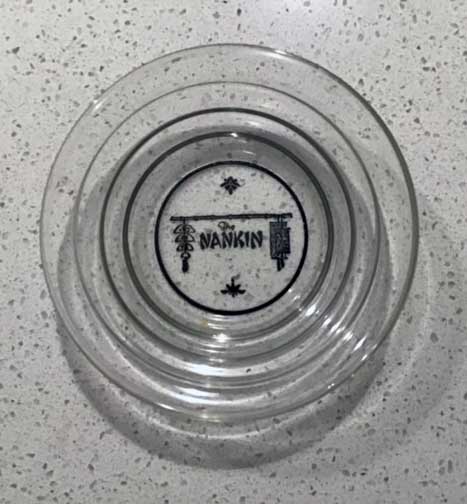
Image courtesy James Lee
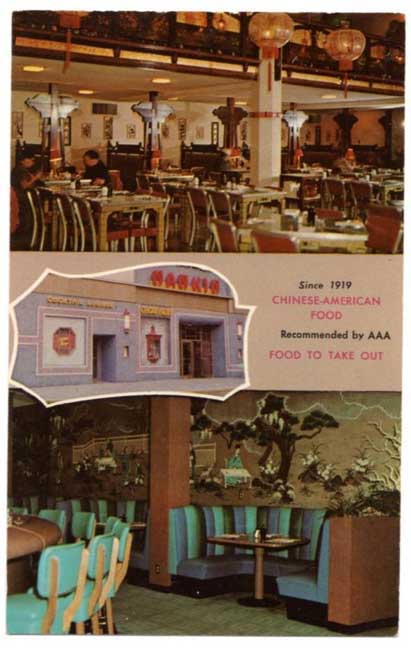
1960 Postcard courtesy Minnesota Historical Society
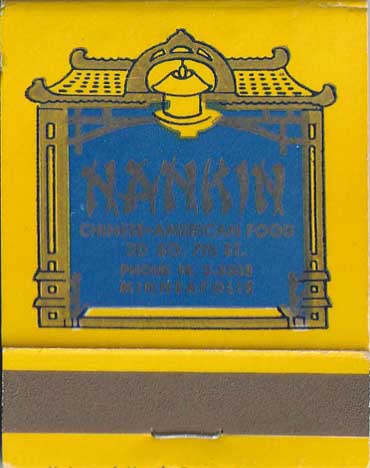
Matchbook image courtesy Gordon K. Andersen
In August 1981 Minneapolis Star columnist Karin Winegar recorded her observations of the restaurant, just before it moved to its third and final location.
Take the Nankin’s food. It’s copious, it’s fast, it’s hot. But it is not gourmet by any definition. Numbers one through seven [items on the lengthy menu, probably variations on the kitchen’s famous chow mein] seem comprised of equal parts brown sauce, celery (Nankin customers consume 20 crates a day) and crunchy noodles (fried on site). The eggs foo yung are the size and texture of junior Frisbees and the sauces arrive in medical-looking paper cups. Enough “wanderer’s punch,” however, and no one notices.
The cheerful, hardcore and silent bus help are part of a crew of some 200 workers, said to be the largest restaurant staff in town. Nankin waitresses and waiters don’t serve as much as deal the plates like cards. They zoom in and out the swinging doors, zip up and down the carpeted stairs. The public never sees the 30 Nankin chefs, 20 of whom can only speak Chinese.
Together, they crack out some 3,000 meals daily. That’s almost a million a year. And in a town which seems to slam its shutters around 9 p.m., the Nankin could be relied upon to serve food until late at night.
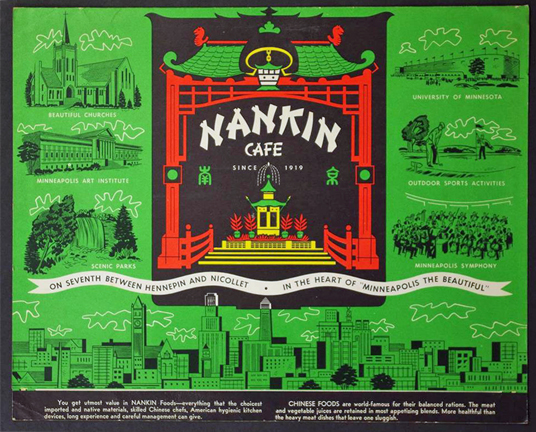
In 1980 the second location at 20 So. 7th Street was razed, along with the entire Block E, to make way for City Center, after its owners agreed to a settlement allowing it to relocate to City Center in 1981 upon completion of the complex.
MINNEAPOLIS LOCATION 3: 7th and HENNEPIN (CITY CENTER): 1981 – 1999
In 1981 it relocated once again to City Center. US Restaurants, the company behind the Green Mill chain, were co-owners briefly in the late 1980s. The Wu family, founders of the Szechuan Star Restaurant in Edina, owned the Nankin from 1989 to 1999.
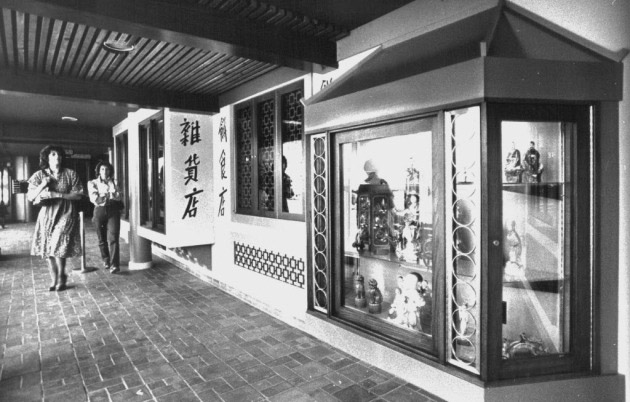
Above and below: The Nankin at City Center, 1981. Photos from the StarTribune, June 10, 2017.
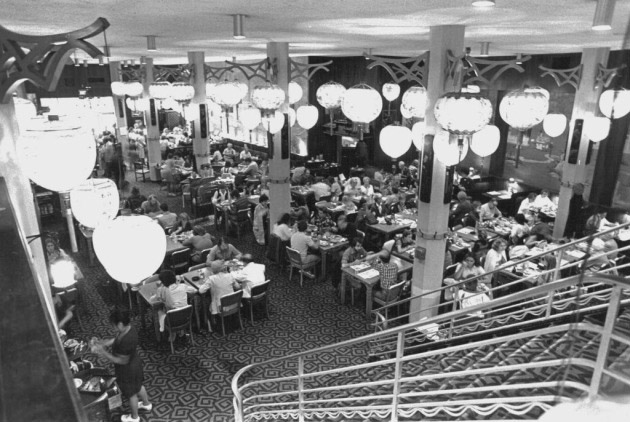
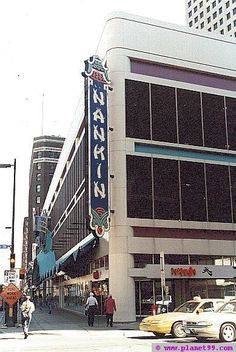
END OF THE NANKIN
The Nankin closed on February 24, 1999, when the owners and the landlord, Brookfield Properties (owner of City Center) mutually agreed not to renew the lease at the end of January.
Rick Nelson’s article in the Strib explained the demise of the Nankin:
The Nankin weathered some hard times in the past decade. Its traditional Chinese-American menu fell out of favor. A strike in late 1988 led to a five-month shutdown. A drug raid by Minneapolis police in early April 1997, in which 19 customers were arrested, didn’t help the restaurant’s fading reputation. A few weeks later, the Wu family filed for Chapter 11 bankruptcy protection, claiming a rent dispute.
THE NANKIN’S SIGN
On March 1, 1999, Barbara Flanagan made a pitch for saving the Nankin’s sign, which was 30 feet tall and contained more than 700 feet of neon. She called it 70 years old, indicating that it had been placed on the original site in 1929. In 1981 it had been put into storage when the owners of City Center banned it from the facade, a decision that was later reversed. After restoration, the sign was installed outside of its final location in November 1984. What became of it after 1999?
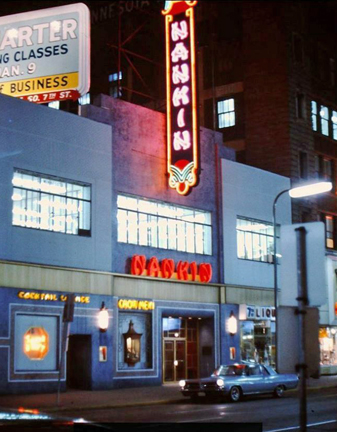
Please see the Blue Horse.
Nashville North was located in Hugo, Minnesota. No street address was ever given in their ads; the description was either North of White Bear Lake on Highway 61 or 30 minutes north of the Twin Cities.
It was new in July 1972, and one of its first performers was Sherwin Linton, who was booked to perform there on Sherwin Linton Day, his birthday, on July 28, 1972. (Minneapolis Tribune, July 15, 1972)
BIG NAMES
By 1973, the Ballroom was booking big names in Country music:
June 15 and 16, 1973: Faron Youngand His Country Deputies
June 30, 1973: Roy Drusky

Minneapolis Tribune, June 1973
July 8, 1973: Tom T. Hall and the Storytellers, with Tom, Dave, and the Better Half; John Peterson; and Betty Lee
July 21, 1973: David Houston Show
August 5, 1973: Stonewall Jackson
August 18, 1973: The Wilburn Bros. (Teddy & Doyle)

Minneapolis Tribune, July, 1, 1973
FOR SALE
In mid-September, 1973, Nashville North was advertised for sale in the Minneapolis Tribune classifieds, and the ad gives some great physical details about the place:
A gold mine. Country-Western lounge & ballroom. Hugo. Services Twin City area. Fully equip. & operating. 1 1/2 yrs. old. Seats 700. 75 x 262 bldg. + 3 acres. Prices to sell NOW. Immed. poss. Owner retiring.
AS YOU WERE
After an apparent hiatus, the big shows were back:
November 3, 1973: The Bill Anderson Show, with Jimmy Gately and the “Po” Boys
November 17, 1973: Faron Young and the Deputies
December 8, 1973: Leroy Van Dyke and the Auctioneers
Patrons were invited to bring their cameras and visit with the stars – only possible at Nashville North!

Minneapolis Tribune, October 1973
1974
In 1974 the Ballroom got its liquor license, and instituted Back to the 50s nights on Friday nights.
February 22, 1974 featured the local group The Rockin’ Hollywoods.
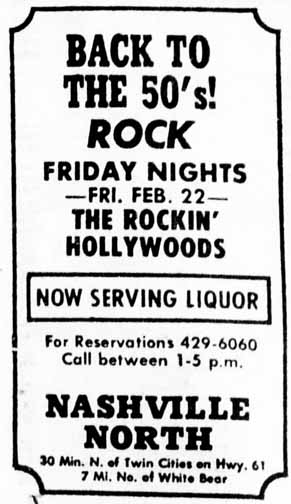
Minneapolis Star, 1974
March 9, 1974 featured Dave Dudley, a combination national/local star.
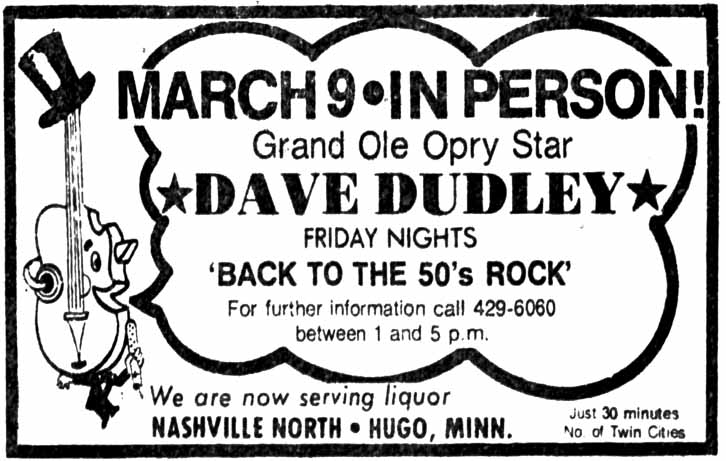
Minneapolis Tribune, 1974
The June 14, 1974’s Back to the 50s band was the reconstituted Castaways.
June 15, 1974: The Faron Young Show with the Deputies

Minneapolis Tribune, 1974
There were no more ads after this – what could have happened to a ballroom that could hold 700 people? It may have failed because of the times – the mid-1970s were in a recession and there were lines and shortages at the gas pumps, and perhaps driving to Hugo was not cost effective. The movie “Urban Cowboy” came out in 1980, kickstarting the Country music revival, but apparently it was too late for Nashville North. If anyone knows anything more about this venue, please Contact me.
The Nest Cafe was located at 731 Sixth Ave. No.
After some comings and goings of previous buildings, the 60′ by 67′ brick building at 729 – 735 Sixth Ave. No. was built in the summer of 1913. According to the addresses, there were apparently four storefronts on the first floor and apartments up above. Among the early stores were a barber shop and a drug store.
The Nest Cafe opened on August 30, 1930, as a jazz venue. The address was usually given as 729, although one ad was given as 731.
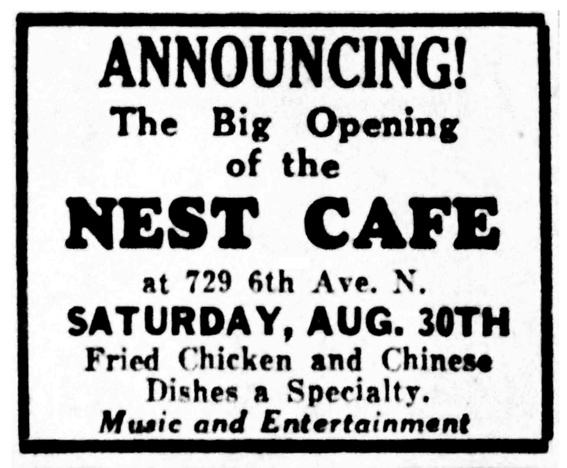
Minneapolis Tribune, 1930
On October 9, 1930, Robert Johnson applied for a dance hall license, but there was suspicion that he was not the real proprietor of the place and the real owner was an alleged north side racketeer behind the scenes. In addition, people complained that the place was too close to Sumner School. (Minneapolis Tribune, October 9, 1930).
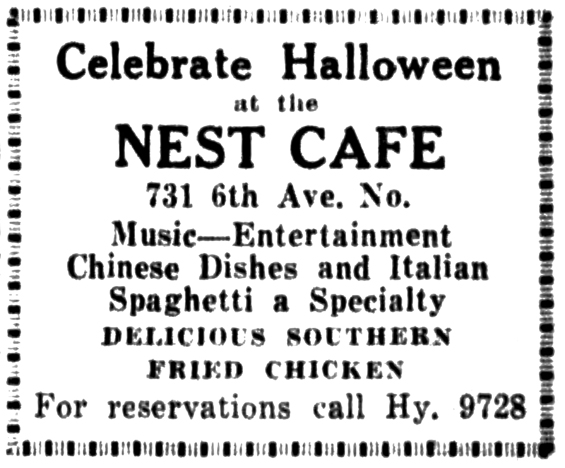
Minneapolis Tribune, October 31, 1930
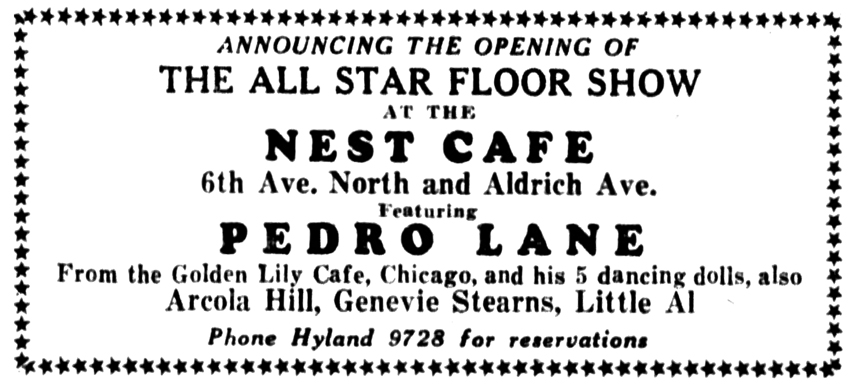
Minneapolis Tribune, November 21, 1930
In December 1930, Robert Johnson was denied a license to resume operation of his dance hall. We know it was open on November 26, 1930, but it was closed in early April 1931, on reports that Chinese cook John Wong had a considerable amount of opium on his person. There were also charges that patrons were allowed to dance although the place had no dance hall license. It was found that there were paid entertainers, but no public dancing was allowed. (Minneapolis Star, April 18, 1931)
But on April 24, 1931, its three licenses were revoked.
THE BUILDING
The storefronts were used by a variety of businesses through the years, including a grocery store, a dress shop, a furniture store, a drug store, a department store, and Lucky’s Place, where you could rent a bicycle.
The building was demolished in about 1957 for the construction of Highway 55 and public housing.
In 1968 there was the “Never on Friday” Club, which apparently was always on Friday. Here you could join other single swingers, age 21 to 35 for dancing and a professional dance instructor to teach you the Funky Broadway. The Club had over 12,000 members and hosted weekly parties, local and world travel, singles apartments and clubhouses.
Please see Mr. Lucky’s.
Please see Lindy’s.
Please see Royal Garden Cafe.
Please see Pershing Inn.
The New Riverside Cafe was Co-op that had two locations on the West Bank. The papers of the organization are held by the Minnesota Historical Society. The following is a historical note written by the Historical Society based on the papers:
1900 RIVERSIDE
The New Riverside Cafe was originally conceived in 1970 by an Episcopal priest, Father William Teska. Teska saw that the future development of the West Bank neighborhood of Minneapolis was dominated by a small group of powerful corporate and government interests leaving little, if any, community control in planning the area’s future. Teska decided that a coffeehouse would act as place where a sense of community and power could grow and serve as an organizational base in the fight to save the neighborhood from urban renewal. In order to raise money for the cafe and provide the West Bank residents with a legal identity, Teska brought together a group of University of Minnesota chaplains and formed the West Bank Campus Ministry. The group raised $2,000 and borrowed another $1,000 as seed money for the coffeehouse.
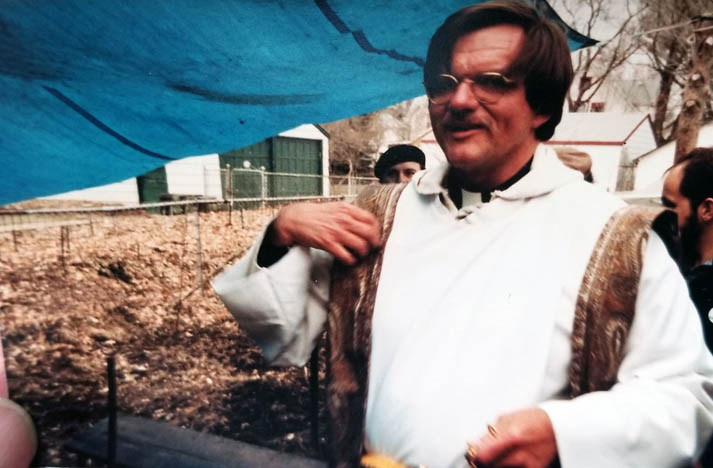
Father William Teska in 1970. Photo courtesy Ken Logsdon
During the Summer of 1970, Teska and others secured a space for the coffeehouse on the corner of 19th and Riverside Avenues.
[This site had belonged to Mel Leslie, whose Coffeebreak Coffee House had been displaced by a Red Barn restaurant in 1965. In the spring of 1970 he was low on cash and there was a lot more to do, so Leslie sold all his equipment, furnishings, dishes, etc. to Teska and the Campus Ministries. — Carolyn Brown Zniewski]
Four people prepared the original location for opening. Early on, Teska recommended that the cafe hire a bookkeeper and manager, but in the second month of operation, during its first workers meeting, the manager fired himself and recommended that a collective form of management be adopted in order to eliminate any hierarchical structure at the cafe. The cafe opened on September 13, 1970, serving only cold food due to its inability to meet the city’s health codes for hot food. At first the cafe’s menu, not being overly concerned with health food, included salami sandwiches, sugared pastries, and cheesecake. However, identifying itself as a place with revolutionary politics, the cafe soon began serving good tasting and wholesome bread, soups, and salads, in spite of the fact that they had to be prepared outside the restaurant and smuggled in.
The cafe also provided an “open stage” all week long and amateurs wanting to perform were free to do so. However, on the weekends the best known local musicians would play to full houses. Later on, featured musicians played every night except Mondays, when the cafe was closed in order to hold collective meetings, and Tuesdays, which was reserved as Open Stage night. The early cafe workers were not really interested in being business people and the business struggled financially, remaining open primarily due to the will of its workers.
Musical entertainment featured folk, blues, and bluegrass.
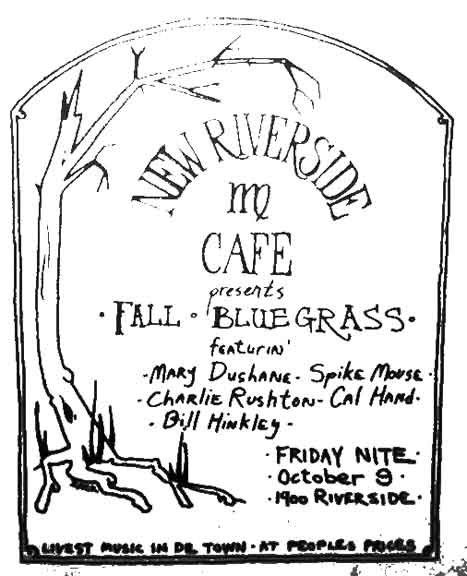
Hundred Flowers, October 9, 1970
In 1971 Hundred Flowers reported that the building was owned by the U of M, which was going to demolish it for a parking garage. And indeed it was.
329 CEDAR
After extensive negotiations with the University, the cafe was relocated to the old Excuse Club bar at the corner of Cedar and Riverside Avenues.
Will Fehlow described the vibe of the old building.
Ancestor energy is strong in this article and picture. When we first moved in, the emanations from past lifetimes were still heavy in 329… I would get chills when working alone late at night with no hubbub to conceal the vibe — the veil between “now” & “then” seemed very thin at times in the building which had seen so much history & after the windows were first un-boarded & we new inhabitants moved in there was a certain feeling coming from just out of sight…
Back to the MHS Historical Note:
Late in 1971, with a great deal of help from the neighborhood community, the cafe opened in its new location. It was soon able to meet the health codes and began to serve a more varied menu of hot foods, becoming the first full service vegetarian restaurant in Minneapolis. By January 1972 the cafe had its own legal identity and severed its ties with the West Bank Campus Ministry.
The collective rented its first collective house in January 1971, and by the summer of 1972 almost all the members were living in one of three West Bank houses. It was decided at this time that wages would be abolished and the cafe would pay all living expenses for the members including rent, food, and personal expenses. The communal living arrangement worked so well that late in the summer of 1972 the collective decided to run the cafe on the same basis. Prices were eliminated and customers were encouraged to “Eat what you need, pay what you can afford.”
In the summer of 1973, faced with a decline in business, the 30 communal members were forced to find new sources of income. The collective, then known as the Dire Wolf Gang, formed an auto repair business, Ace Truck Parts; a moving company, Macho Movers; and a vegetarian catering service, Funny Foods. The businesses all operated out of the cafe and were staffed by collective members. This period of communalism lasted three years before the cafe reverted to more traditional business practices in 1975. The collective structure remained intact, however, and would remain the cafe’s method of management for the next 22 years.
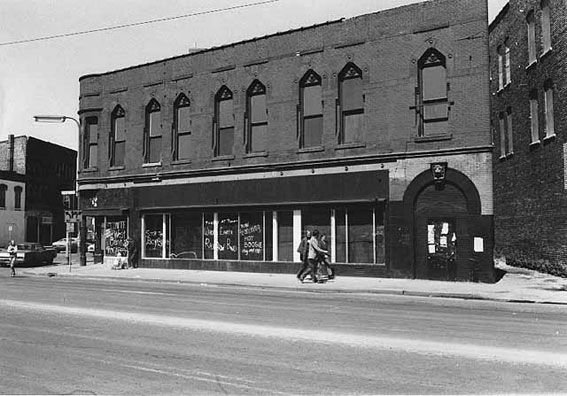
329 Cedar Ave., 1972. Photo courtesy Minnesota Historical Society
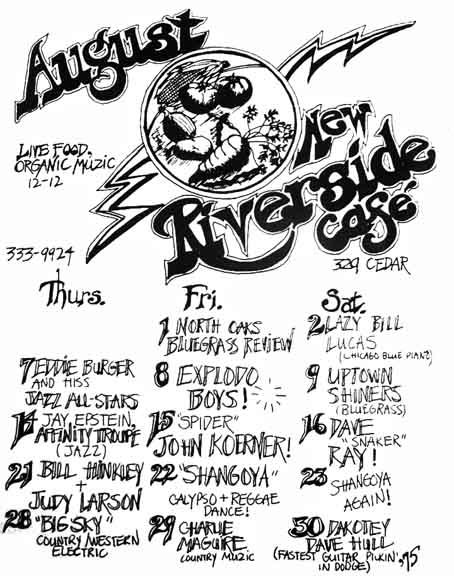
1974
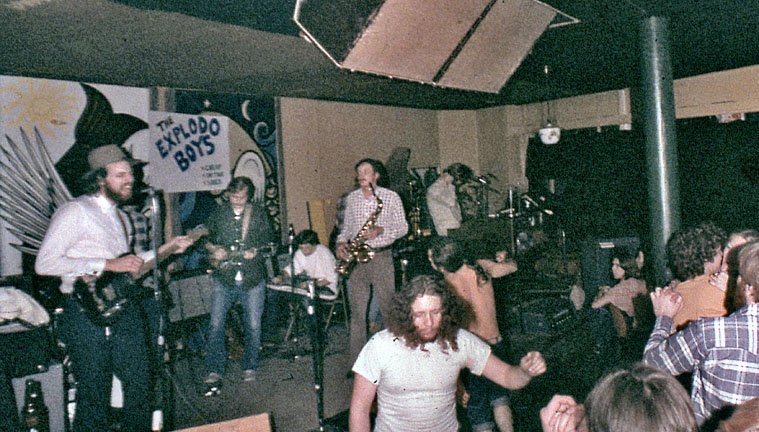
The Explodo Boys, August 1974. Photo courtesy Stephen Cowdery
During 1975 and 1976, the collective members occupied the cafe building in order to block its planned demolition by Cedar Riverside Associates as part of the Cedar-Riverside Apartments development. In November 1977, due to its participation in a rent strike with over 150 members of the West Bank Tenants Union, the cafe received an eviction notice from Cedar-Riverside Associates, at the time the largest private landlord in the state. The collective threatened to occupy the cafe if the eviction was carried out. The Cafe’s case came to trial on February 8, 1978, and the jury returned on February 13, 1978, with a verdict against the Cafe. However, rather than accept the Cafe’s back rent and allow it to stay, the landlord appealed the case to the Minnesota Supreme Court. Cedar-Riverside Associates won the appeal on June 30, 1978, but the following day, July 1, 1978, another court action resulted in the appointment of a new landlord and Cedar Riverside Associates’ loss of the legal right to evict the Cafe.
During the 1980s and 1990s the Cafe’s political activity subsided and the collective concentrated its efforts towards maintaining the Cafe’s economic viability. In 1984 the Cafe bought the building from the city of Minneapolis and, due to major structural problems, implemented a $390,000 building renovation. Due to financial problems the New Riverside Cafe closed onMay 10, 1997, marking the event with a public wake held on May 23, 1997. During its 27-year history as part of the West Bank community, more than 300 collective members worked at the cafe, 1,040 musicians performed there, and approximately 10,000 customers were served.
The New York Public Library, previously known as Akiva, was a coffeehouse on Cleveland Ave. near Buford Street, across from the University of Minnesota’s St. Paul Campus.
Brian Morgan was a co-owner, and described the scene in about 1963:
The after-the-bar crowd was big. We gave Lazy Bill Lucas his first solo work here. the university pressured us out of business after about a year and a half because they didn’t like that “degenerate” coffeehouse across the street. (Minneapolis Star, December 16, 1975)
Nick’s Cafe was at 1501 So. Street from 1936-42 and advertised in the Minneapolis Bowling News. (I read everything, folks.) “Come and Enjoy Yourself With Music and Dance.” “Free Prizes to Bowlers Only.” “Where Old Friends Meet.”
The Nickel Joint must be one of St. Paul’s oldest surviving taverns. Located at 501 Blair Ave., in the Frogtown neighborhood, its website says that it has been open since 1905 – no explanation of the Prohibition years.
The St. Paul Musicians’ Union newsletter going back to the early 1940s mentioned the Nickel Joint early and often.
It is said to have been a Jacob Schmidt “tied house,” meaning it was owned by the brewery and the family running it lived in the building. Thomas Keim, on the Old St. Paul Facebook page, explained that
There were usually five tap handles, with four belonging to the owner/brewery and one guest tap where the family could choose any beer they wanted.
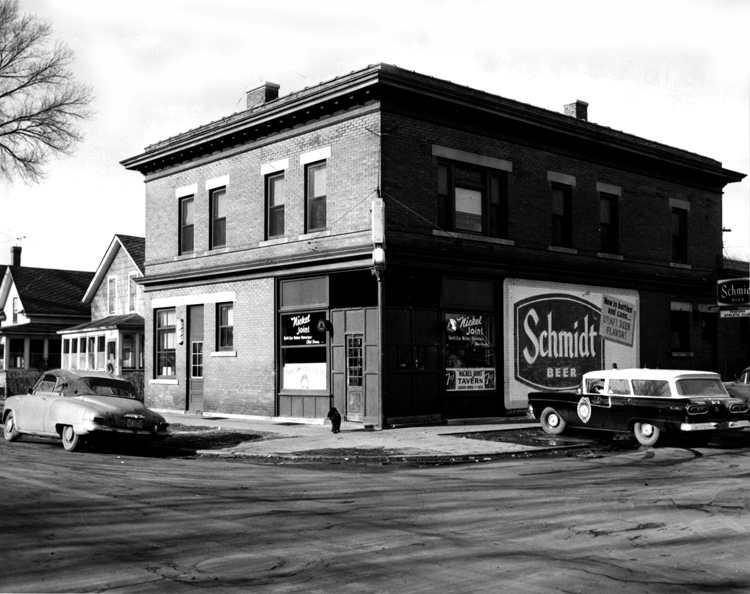
1957 Photo courtesy Minnesota Historical Society
NICKEL SPORTS BAR
Now to find out that by 1992 it was the Nickel Sports Bar, thanks to Rob Schabert posting the image below on Facebook!
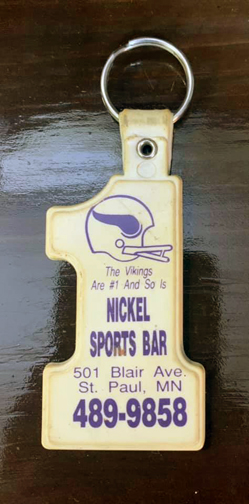
1992 Keychain image courtesy Rob Schabert
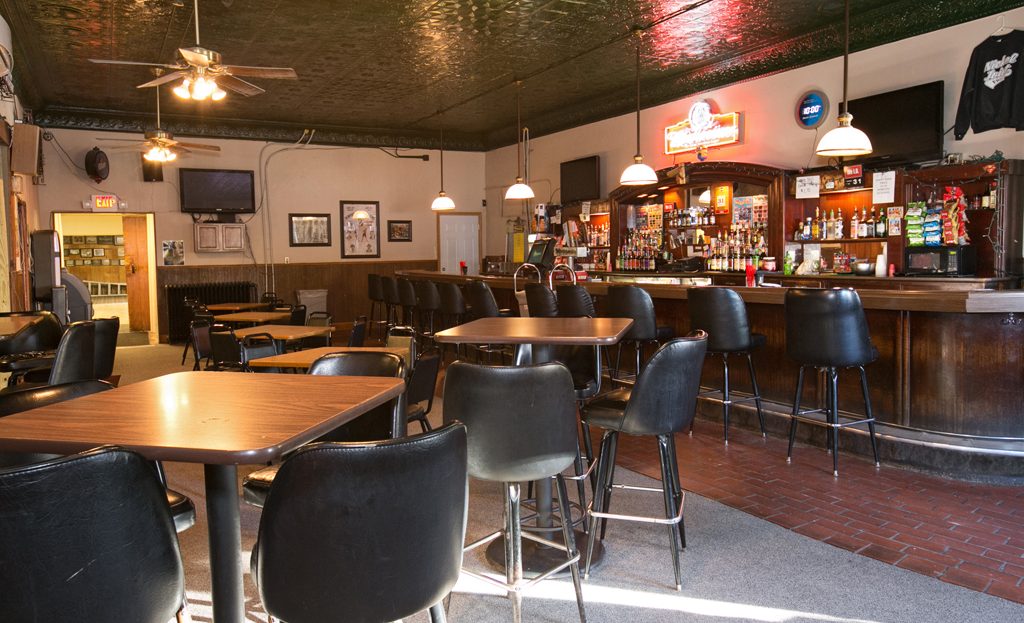
The Bar, 2016
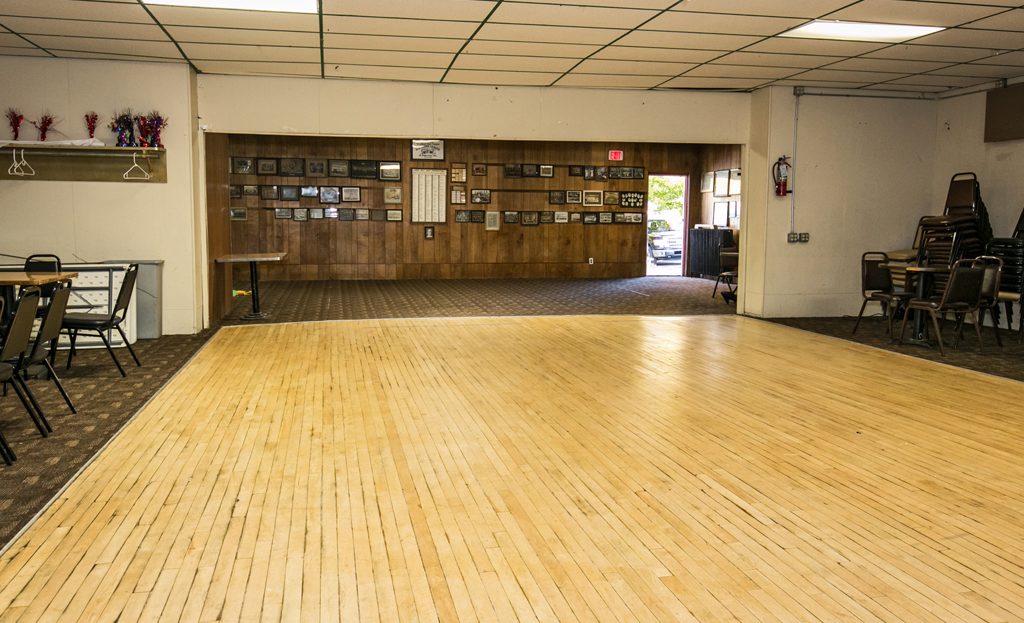
Dance Floor, 2016
Minneapolis
Nicollet Cafe was a 3.2 beer tavern on Nicollet Ave. just north of 26th Street; briefly a jazz venue in the late 1950s. It had a large audience from the nearby Minneapolis Art School, but was unable to continue Sunday jazz.
Okay, this wasn’t really called Nicollet Hall, but I had to call it something. It was located in a building at 723-729 Nicollet Ave., across from Dayton’s Department Store. There was apparently a hotel there in 1889, but the 66 ft. by 122 ft. brick store building was erected in 1900 for $35,000. I’ve yet to discover if there was a name for the building.
There were three stories, with a “hall” on one of the top two. Many thanks to Noel Mertz, who found the photo below. The building in question is the one hosting Mary Jane Shoes, best as I can tell.
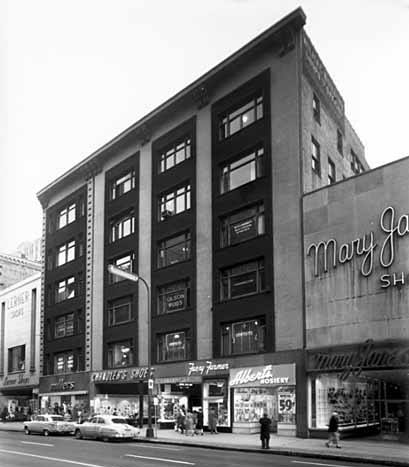
1958 Photo courtesy Minnesota Historical Society
The hall was known by many names over the years, including:
- McElroy’s Hall (1905 – 1912) – more of a venue for meetings and private dances, etc.
- Mrs. Beck’s Dreamland (December 1912). This was a dancehall by the looks of it, but Mrs. Beck was a dance teacher, specializing in Stage Dancing:
- Buck and Wing
- Waltz
- Clog Lancer
- Clog Schottische
- Grotesque
- Fancing Dancing
- (Williams’) 8th and Nicollet Hall (1920 – 1921)
- The New Nicollet Danceland (February 1924)
- Fairyland Ballroom (November 1924 – S.H. Kahm, permit holder)
The building was demolished in 1969, and the IDS Tower, built in 1972, sits in the spot today.
The Nicollet Hotel was located on Washington Ave. at the confluence of Hennepin and Nicollet in Minneapolis. Thanks to Jeff Neuberger for help with this page.
The first hotel at that location was opened on May 26, 1858. According to the photos in the MHS database, it was known as the Nicollet House until about 1905. The photo below shows that by 1908 it was known as the Hotel Nicollet.
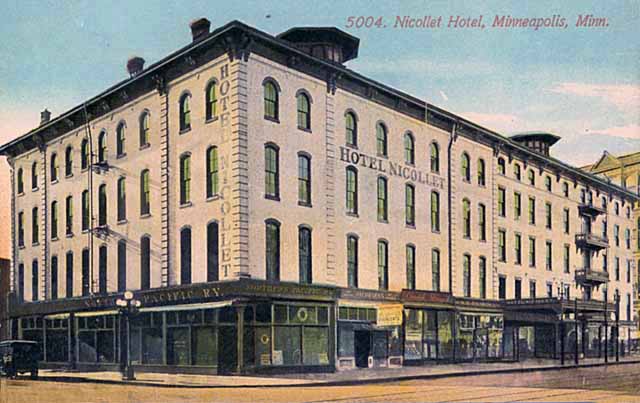
Hotel Nicollet, 1908. Photo courtesy Minnesota Historical Society
That first hotel was replaced by a much larger building, opening in June 1924. It had 637 rooms on 12/13 stories. It faced Gateway Park, which still looked inviting in the 1925 postcard below. In the course of 30 years the Gateway would thoroughly disintegrate into Skid Row, and the Gateway Building pictured below would be demolished at the end of July, 1953.
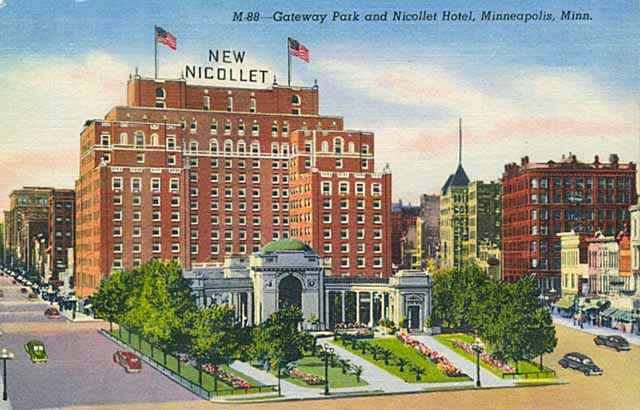
VENUES
Within the hotel there were various places to eat, drink, and dance, with changes made from time to time. I can’t promise to name them all during its 50-year history, but here are some of the more successful ones.
In 1935 Chickie and Sunny was a Famous Nicollet Hotel Dance Team, per an ad in the Hennepin County Review (they were moonlighting at the Vine Hill Tavern).
THE MINNESOTA TERRACE AND THE CHATTERBOX
This was a $50,000 addition made to the hotel, opening on October 8, 1936. Bob Crosby was the first orchestra leader. It consisted of the Minnesota Terrace, a dining room/supper club/dance venue, and the Chatterbox cocktail lounge.
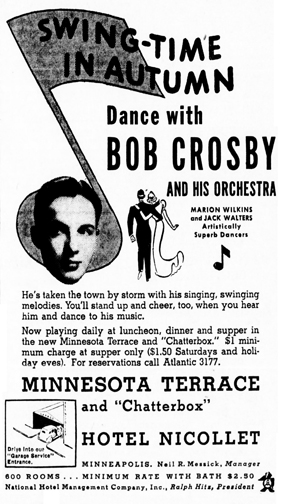
Minneapolis Star, October 8, 1936

Minneapolis Tribune, November 27, 1936
Stebbins:
Once during the 1940s, when Fats Waller’s band was playing along with the all-Negro Naval Dance Band, a jam session par excellence developed. In 1944 the Terrace featured a Gay Nineties Revue, starring the Three Gay Blades, Earl and Josephine Leach, the Lovely Selma Marlowe Dancers, and Perry Martin and His Orchestra. The Minnesota Terrace lasted through 1952. It was Minneapolis’ major ballroom, where one could hear a “name” dance band. The Marigold was a runner-up with an occasional name band.
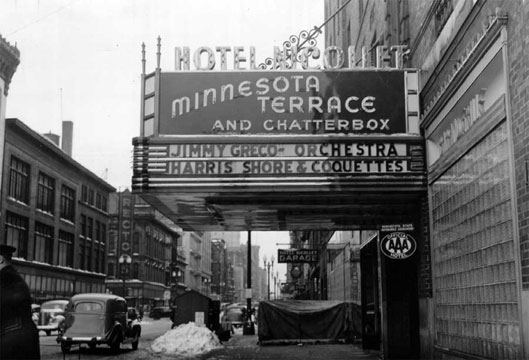
Photos above and below dated 1937, Minnesota Historical Society
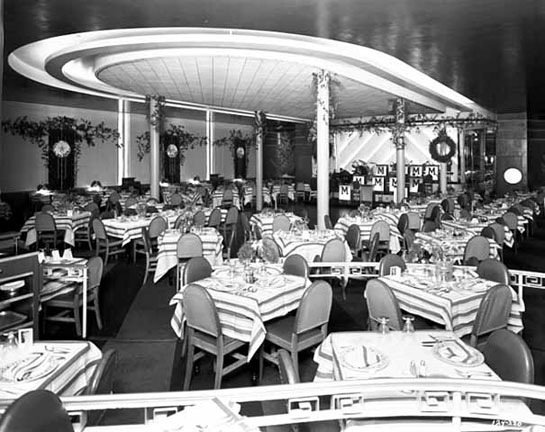
Dining room and dance floor, Minnesota Terrace
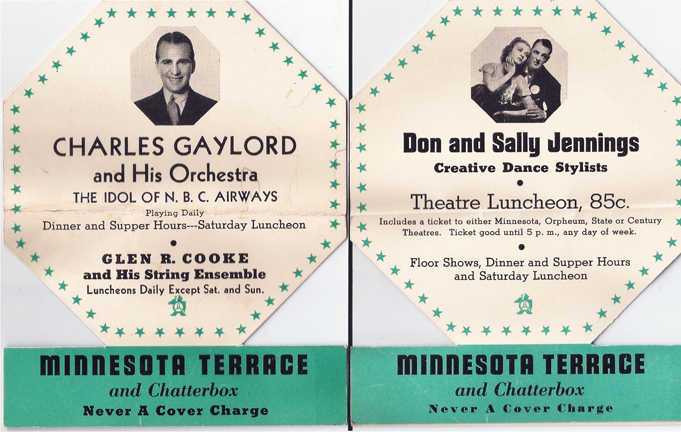
Saralyn Durheim found this ad in her grandmother’s things and graciously shared it with us!
THE NEW CHATTERBOX
According to ads in the Minneapolis papers, the Chatterbox gave way to the Chatterbox for Ladies from June 7 to June 20, 1940. Apparently the concept didn’t catch on, or it was too sexist, even in 1940….
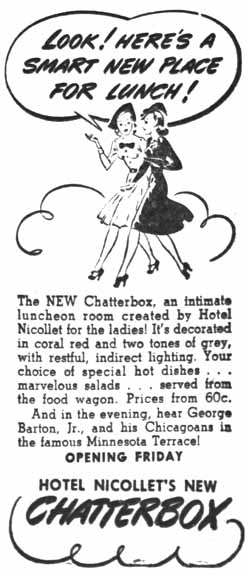
THE WAIKIKI ROOM
Neil Messick of the Nicollet Hotel created the Waikiki Room after thinking it about it for eight years. James Lileks has pointed out that it might not have been such a good idea for returning servicemen who spent their time of service in the jungle, but the women loved it.
Another note: Although Don the Beachcomber (born Ernest Beaumont-Gantt, who legally changed his name to “Donn Beach,”) was instrumental in opening the Waikiki Room in 1952, he opened his own franchise at the Hilton Hotel in St. Paul in 1966.
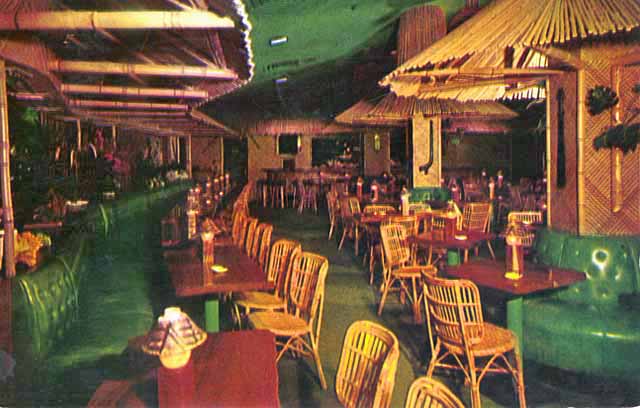
1955 Image courtesy Minnesota Historical Society
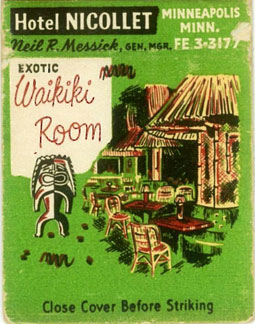
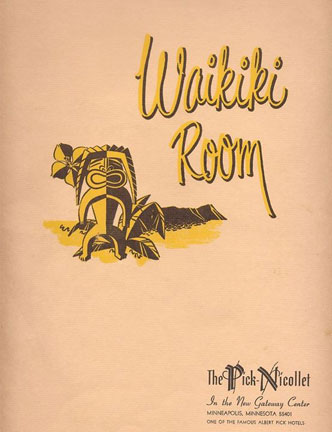
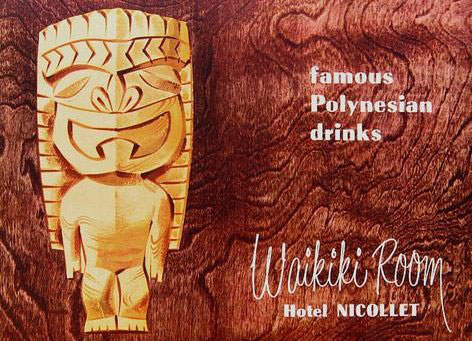
SOUL’S HARBOR
Despite being purchased by the Albert Pick Hotels Company in 1957 and renamed the Pick-Nicollet Hotel, time and location were not kind to the venerable building, and it fell into disrepair. In 1973 it was purchased by the Calvary Temple for $1.5 million. The religious organization primarily used it for housing, but found it difficult to keep up with payments, and went bankrupt in 1985. Everything inside the building was sold, and it stood empty until it was finally demolished in 1991. It was used as a parking lot for at least 28 years.
The Nifty Cafe was in St. Paul in 1941 – Artie E. Boyd, proprietor. Not sure if they had music, but in October of that year they opened the Blue Room, “a cozy upstairs addition over the main cafe,” reported the Spokesman. “The Blue Room is suitable for small gatherings such as card parties and meetings.” It just sounds like it should have music.
The story of this folk music venue at Macalester College is told by Lynn Saeger:
In 1968 the coffee house scene was popular, and the Student Activities Committee decided we needed one on campus. There was virtually no entertainment (since they ended mandatory Chapel lol) and the college was not opposed. A storage room in the basement of the student union was fixed up with a small stage, cafe tables, etc. to create an intimate performance space. Sounds great? Ah, but nothing is simple. Entrance to the coffeehouse was through The Grille restaurant, where I slaved as dishwasher and busgirl. Organizers planned to use the kitchen for preparing the coffee and snacks they would sell but the private company who owned the Grille said fuggedaboutit. The city inspectors told the college it couldn’t happen because the room had “no exit.”
But at Mac, there was nothing more exciting than a righteous cause and students rose to the challenge. After rallies and picketing the school more or less agreed to look the other way if a sign was posted, hence the name “No Exit,” and a ladder was placed that could reach an outside window. Coffee was produced via plug in percolator. A steady stream of local folk singers entertained us…I remember Jim Frey and Bruce Cottrell and a guy named Shawn with long hair. Leo Kottke, too. John Denver may have stopped in but I don’t personally remember it. I don’t know how long before the inspectors caught up with No Exit, but we surely had a good time!
There were several Norden Halls around town – they were apparently Scandinavian versions of Masonic Temples.
They generally had large halls that were designed for banquets, meetings, dances, and – the earliest one I found in 1871 – “literary entertainments.”
It was in one of these buildings that two music venues of the 1930s were located – 20 University Ave. SE.
Please see Duffy’s.
The Normandy Inn is located at 405 So. 8th Street, in Minneapolis. It was built in 1925 and is still in operation.
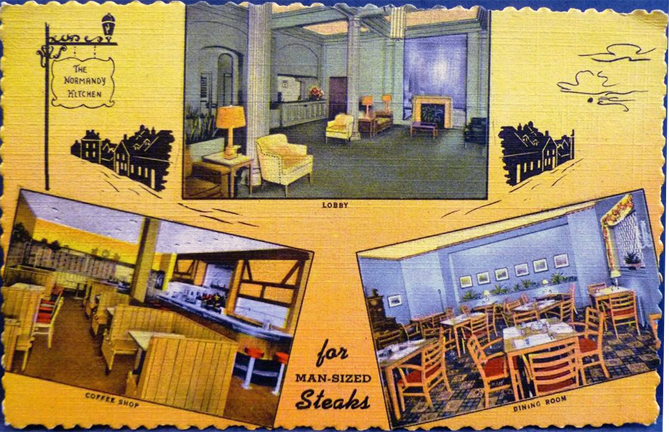
1948 Postcard From the Collection of Mark Youngblood
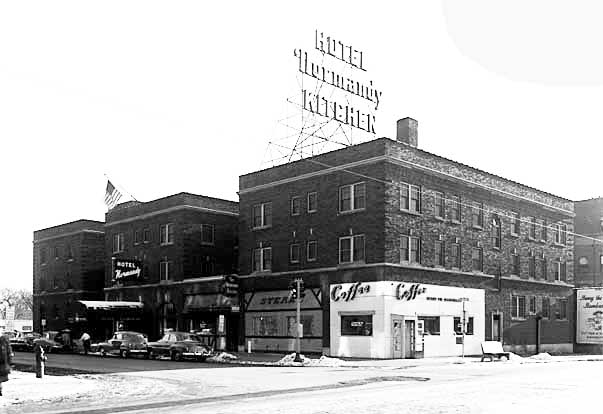
1953 Image Courtesy Minnesota Historical Society
The Normandy Village restaurant opened in 1957. It was decorated with hand-rubbed paneling with velvet inserts and stained glass. 1963: Cocktails and back room piano bar. 1969: Jerry Vaughan at the piano; 1970: Sing-a-long piano bar for gay crowds.
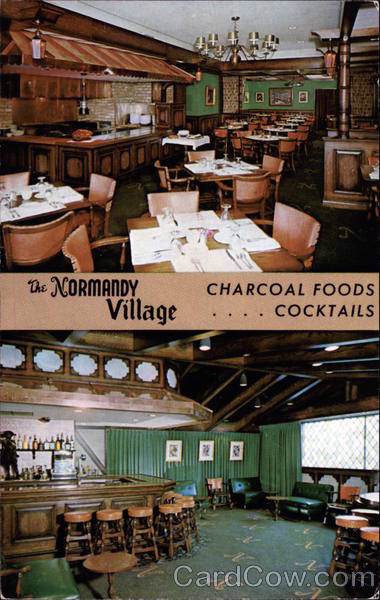
Northern Bar featured jazz during at least 1961-64
University of Minnesota, Minneapolis Campus.
This was the site of mostly more sedate musical events – operas and such – but did host some folk and a little rock ‘n’ roll in its time.
One fun fact comes from Rick Liljeblad, a dedicated fan of Howdy Doody. It concerns the link between Northrop and the term “Peanut Gallery,” which has become part of our vernacular.
While attending the University of Minnesota, Business and Advertising major E. Roger Muir worked on campus as an usher at Northrop Auditorium. Students could purchase discounted concert tickets for 50 cents and Roger would seat them in the rear section of the balcony, which was affectionately referred to as the “Peanut Gallery.” [This was a term from the days of Vaudeville, when kids in the worst seats would throw peanuts at bad performers.]
After serving in the Army Signal Corps during WW II, Roger found employment as a staff producer at NBC in New York. In 1947 NBC started airing the show “Puppet Playhouse,” hosted by Bob Smith and produced and directed by Roger. It was Roger who christened the live studio audience of children the “Peanut Gallery.” “Puppet Playhouse” became the “Howdy Doody Show,” and the rest is history!
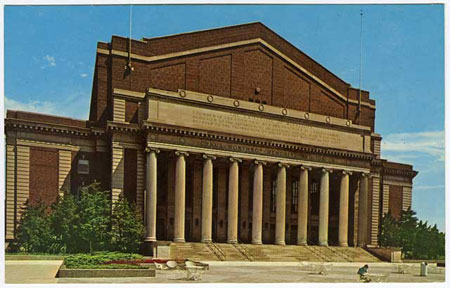
Northrop Auditorium – photo from Minnesota Historical Society
1011 OLSON MEMORIAL HIGHWAY
The first mention of the Northside Inn in the Minneapolis papers is in December 1935. The tavern sponsored a baseball team from 1941 to 1948.
An ad selling all of its fixtures was published on October 9, 1957. This location was replaced by the Twin Cities Opportunities Industrial Center in 1961.
546 OLSON MEMORIAL HIGHWAY
The new Northside Inn was owned by Rodger Benton. Whether it had music is unknown.
The building was very old, and in 1939 had been used by the Sunrise Food Products Co. to make potato chips, perhaps among other things.
The first mention in the papers of the Northside Inn was in December 1957, with the report of a shooting. A knifing was reported in 1958, and a spate of shootings, robberies, and knifings were reported in 1959.
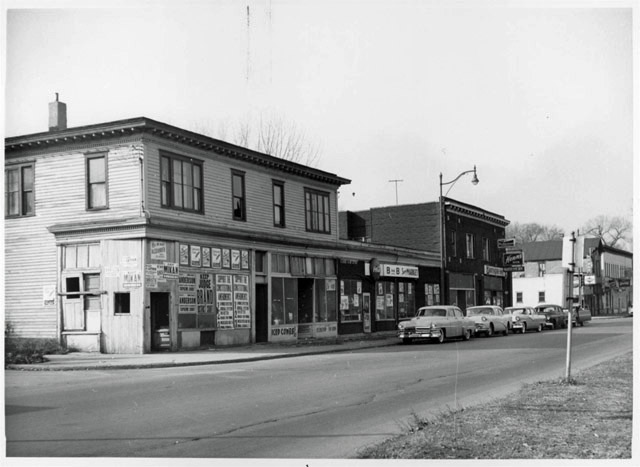
The Northside Inn is the darker building on the right. Photo courtesy Hennepin County Library via Alan Slacter
The last straw was a shooting on October 9, 1959, which wounded a policeman and killed a bystander. The assailant, who was also wounded, was sentenced to 30-80 years in prison. At the scene were found several whisky bottles (remember this was a 3.2 only tavern). At this point, James T. Fuller, Sr. had just recently become a co-owner, and was on the scene when the shooting happened and the whiskey was discovered. He was arrested and charged with spiking the beer. He was eventually acquitted for lack of evidence.
Revocation of its 3.2 license was advocated by Alderman Walter Halloran at a City Council meeting on January 6, 1960; cited were numerous “shootings, knifings and other trouble.” Although attorney Gerald Singer insisted that Benton and Fuller had been taking steps to improve operation of the tavern, Police Chief Milton Winslow read a list of offenses to the Council, ending with the fatal shooting the previous October. Winslow said that patrolmen have “reported a remarkable lack of co-operation” from the owners.
The fact that the establishment was “primarily a colored place” was brought up by Alderman Frank Wolinski. “It’s a tough place. We closed up Jimmy Baker’s Good Eat Cafe, and now ask Halloran what’s happening in his ward, or downtown. I just want you to see the problem we have along Olson Highway.”
Alderman Frank Moulton noted that “all this talk about color is beside the point,” and that “any place should be closed up if it requires an undue amount of police protection.”
At that point “Fuller left the room shaking his head, predicting the place would be operating again within two months.”
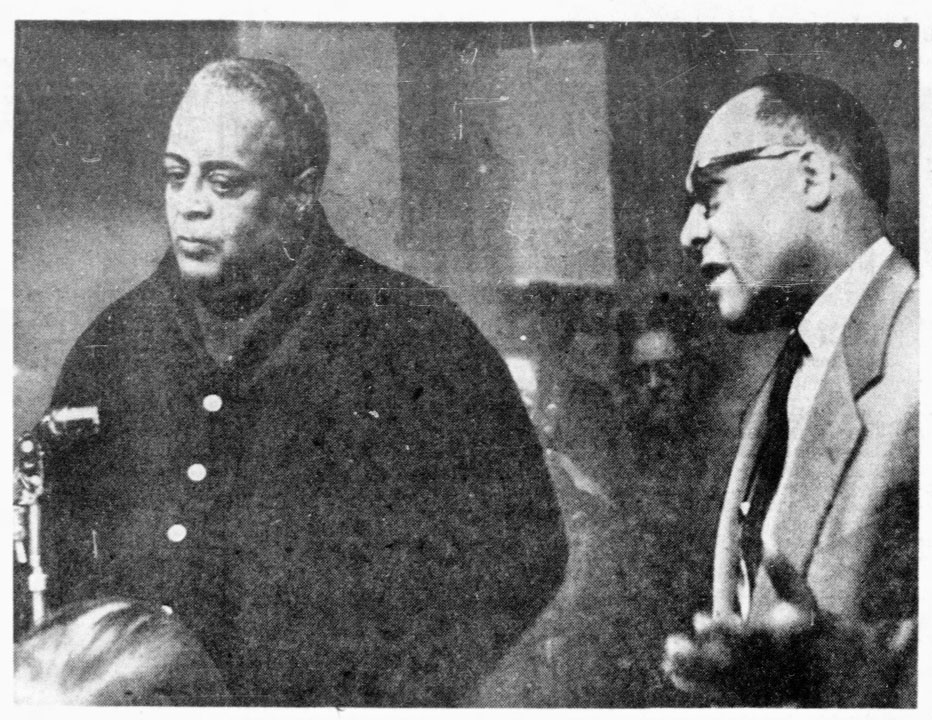
Benton and Fuller at the January 6, 1960, City Council hearing – Minneapolis Tribune photo
THE REGAL TAVERN
The Inn’s 3.2 license was renewed in May 1960, this time with Fuller as the sole owner. He reopened the place at the same address in November 1960, this time renamed the Regal Tavern. It became a place for black entertainers to come after their gigs.
Other evidence of its musical pedigree is that on July 18, 1964, a man accidentally shot himself while dancing. He had a gun in his waistband with a defective safety lock. And that’s the last we hear of the Regal Tavern.
An item in the Minneapolis Star indicates that in October 1969, the address was that of the Robert White Post 437 of the American Legion, which was raided and charged with selling liquor without a license.
The building was demolished some time after 1972. In its place is now Metro Transit’s Fred T. Heywood Office Building, located at 560 Sixth Ave. North, at the corner of North 7th Street and Olson Memorial Highway. The Heywood Garage opened in 1984, replacing the Northside Garage, which was located on Washington Avenue in the North Loop.

Heywood Garage
The Northstar Center was located at 618 Second Ave. So., Minneapolis. It was built in 1961-62, and was the site of the first skyway, connecting it to the Northwestern National Bank. It included the Northstar Inn Hotel and several large businesses such as Pillsbury and Cargill.
ROSEWOOD ROOM
1963 menu included chateaubriand, pompany pappillot, and breast of capon Waikiki. Dancing Friday and Saturday.
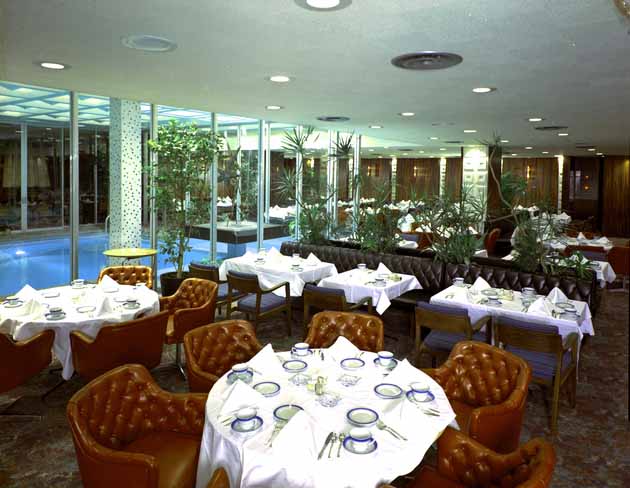
Rosewood Room, 1963. Photo courtesy Minnesota Historical Society
COPPER HEARTH
1963. “Stepping Out? Know What’s ‘In’…Jimmy Bowman is ‘In”… The Copper Hearth… is… ‘In’… Northstar Inn …. is ‘In'” Men only at lunchtime! 1970: Piano bar moves with the styling of Sally Saylin.
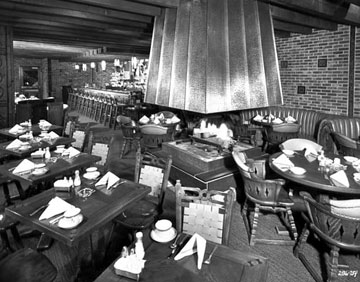
Copper Hearth, 1963. Photo courtesy MNHS
BUSTER’S
This matchbook was posted by Theresa Oberuc. Different address, but says Northstar Center. Dave Bogdan tells this story:
Worked for Pillsbury ’79 to ’90. Buster’s was above our computer center in the basement. Their beer bottle tube stuck out of the ceiling above our page printer and would drip slightly on the printer. A little gross.
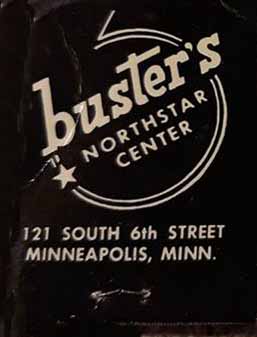
2409 E. Skillmann Ave., No. St. Paul. 1970: Live entertainment on weekends.
Norway Hall was located at 2902 Chicago Ave. So. in Minneapolis.
THE BUILDING
Norway Hall was built in 1923 as “brick lodge rooms,” according to the city’s permit card. The cost on the permit was listed as $41,000; in the newspaper announcement it was $55,000. Funds for its erection were provided by the Oslo Lodge of the Sons of Norway, the Alfheim Lodge of the Daughters of Norway, and the Sigyn Lodge of the Daughters of Norway.
The building was designed by architects Long & Thorshov, and built by Andrus construction. The fact that we cannot find a photo of this building makes one wonder if it may not be one of the most inconspicuous buildings in Minneapolis…
The two-story red brick structure had stone trim and a red tile roof. The frontage on Chicago Ave. was 68 feet, and had a depth of 110 feet. “The exterior and interior have been designed in a Norse feeling.” Clubrooms were on the ground floor at the front. Offices were on the second floor. Two lodge rooms, each two stories high, were located in the back of the building. The two rooms could be divided by folding doors or turned into an auditorium that could seat 600 people. A dining room, smoking room, and other facilities were planned for the basement. (Minneapolis Tribune, October 7, 1923)
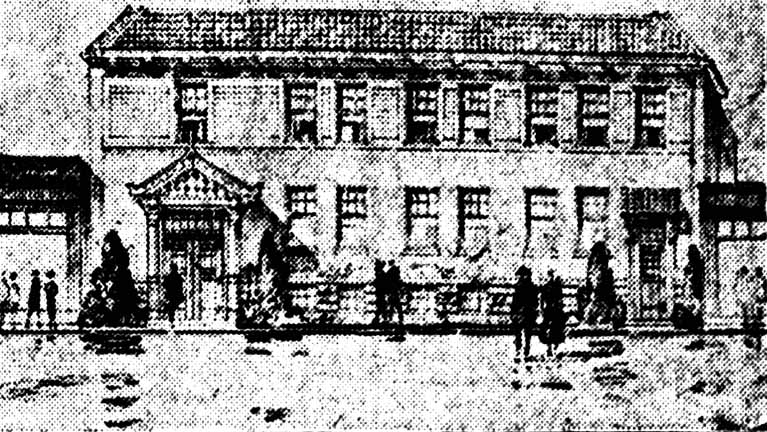
Sketch of the impending Norway Hall, Minneapolis Tribune, October 7, 1923
TWO DIFFERENT WORLDS
Researching the entertainment activities inside Norway Hall is reliant on which newspapers one reads. The resources I used were:
- The Minneapolis Star and Tribune were the mainstream papers of the time, with the Tribune being circulated in the morning and evening, and the Star in the evening only. Both papers were owned by the same company. These papers are available in a searchable database online for a subscription fee.
- The Minneapolis Spokesman has been the primary newspaper for the black community since it was started in 1934 by editor Cecil E. Newman. It was a weekly paper. It carried national as well as local news concerning the black community. Back copies of this paper are now online, thanks to the efforts of the Hennepin County Library and the Library of Congress. This is a free resource. My thanks to James Orndorf for his reminder of this fact!
THE SCANDINAVIAN COMMUNITY
Events catering to the primarily Scandinavian community can be found in the Minneapolis Star and Tribune. The first ad for an event at the new hall was on April 30, 1924. This was a recital by a soprano accompanied by a violinist. From then on it was a busy place, offering concerts, plays, a meeting place, and other functions of a large hall.
The ad below for a New Year’s Eve dance featuring Slim Jim (Iverson) would have been popular with the Norwegians in Minneapolis, if you could get them to attend such a scandalous affair!
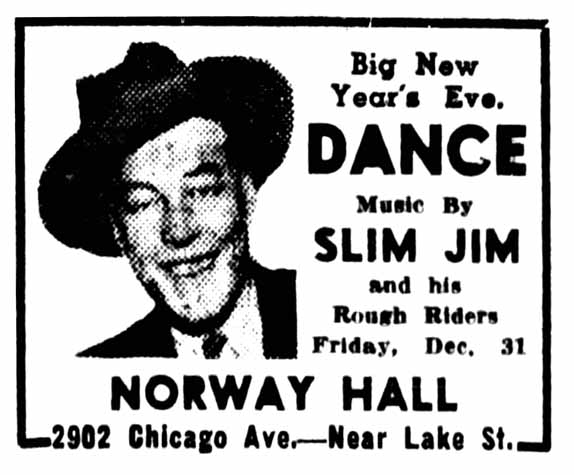
Minneapolis Tribune, December 31, 1937
1940
Regular dances started up in 1940. The ad below is billed as a Grand Opening Dance, but may just be for the season. It was in September, and the hall may have been closed in the summer because of the heat. Ted Johnson was a frequent purveyor of the music at Norway Hall.
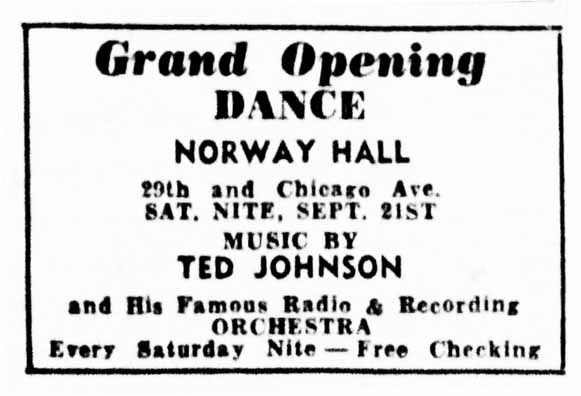
Minneapolis Tribune, September 20, 1940
1945
Dances generally stopped during the War years of 1943 – 1944. They started up again with regularity in March 1945. The ad below says that Ollei Skratthult will sing some of his best songs. Now that’s a good Scandinavian name!
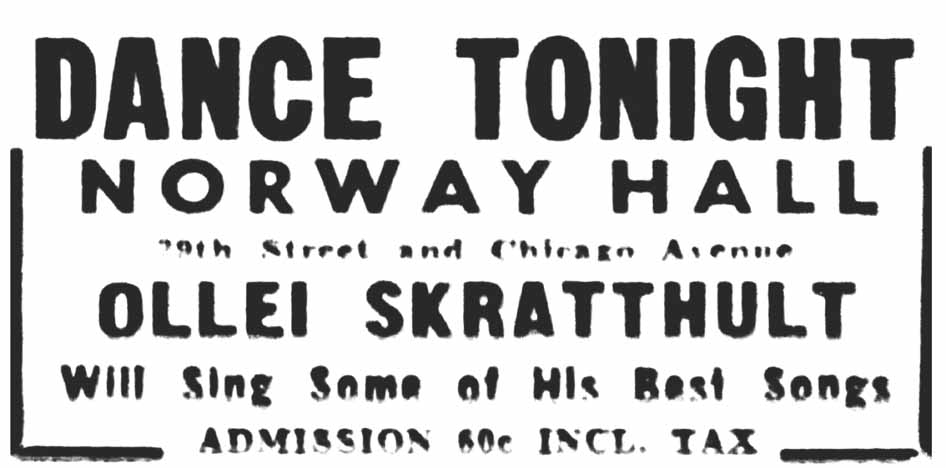
Minneapolis Tribune, March 10, 1945
1946
Ted Johnson was back for the 1946/1947 season.
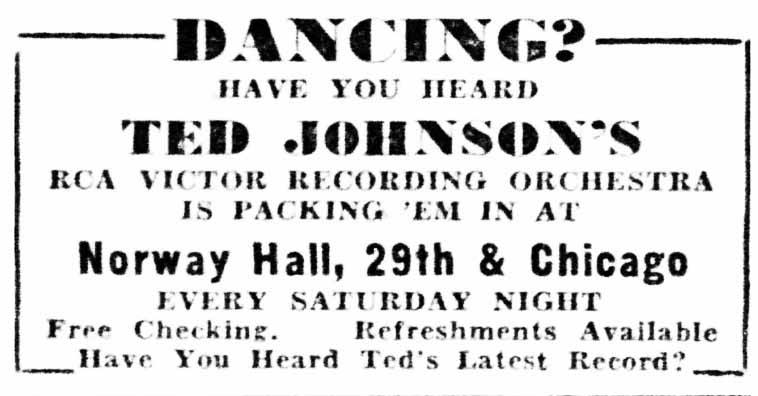
Minneapolis Star, January 3, 1947
1949
In September 1949 we see the advent of Thorstein Skarning, a character who someone should write a book about. But competition between ballrooms was tough, and he was soon replaced by the Scandia Rhythm Orchestra the next month. Skarning would be back later in 1950.
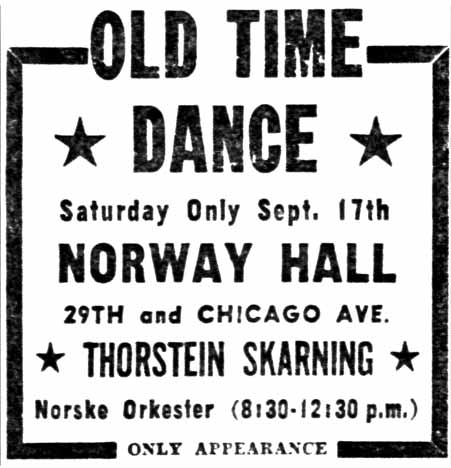
Minneapolis Star, September 13, 1949
No ads for dances from 1951 until last one on February 1956?
THE BLACK COMMUNITY
The Minneapolis Spokesman contained many ads for dances and shows at Norway Hall. Ads go back to at least 1935, and these events may have been going on even further back. None of these events are advertised in the Minneapolis Star or Tribune. I’ll start the chronology over with these ads.
1935
The first ad I found was a dance given by the Credjafawn Club. Most of the dances were sponsored by private clubs. The Credjafawn Club got its name by combining the letters of the names of the women in the club. Entertainment was provided by Eli Rice and his Dixie Cotton Pickers, a very popular group at the time.
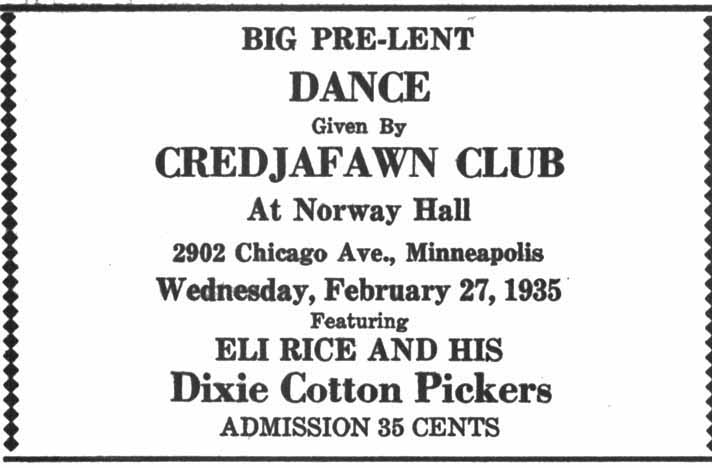
Minneapolis Spokesman
1936
The ad below is for a Style Show and Dance. Seems like women would be more interested in a style show, but they must have taken their husbands along to dance with afterwards.
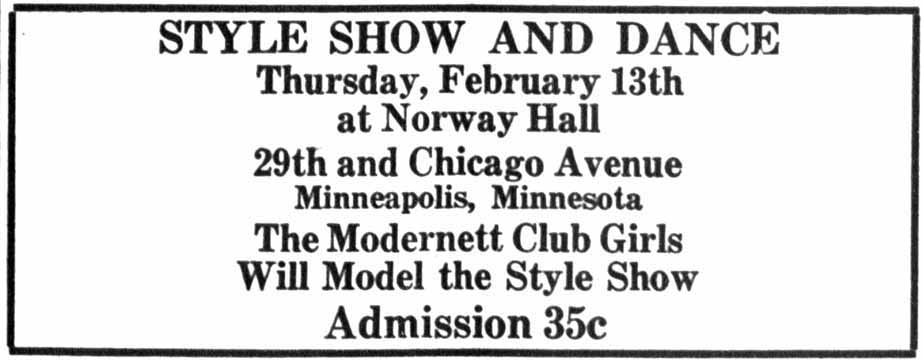
Minneapolis Spokesman, 1936
The Minnesota-Iowa Club gave a Cabaret Dance Party on May 11, 1936, with the theme “A Night in Spain.” Roy Dysart’s Band played for dancing, and a floor show was promised!
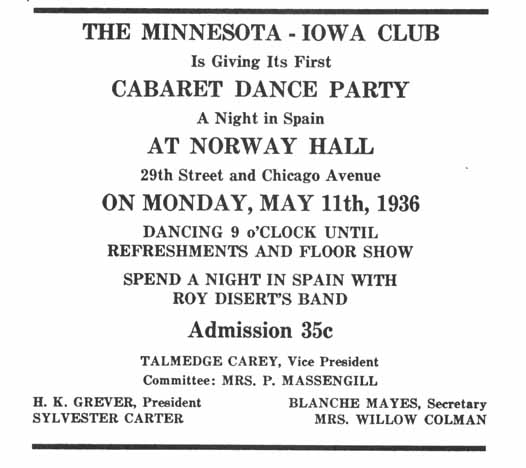
Minneapolis Spokesman, May 1, 1936
A Gigantic Labor Day Dance was sponsored by the Gloom Chasers Club on September 7, 1936. Ray Dysart’s Band again provided the music.
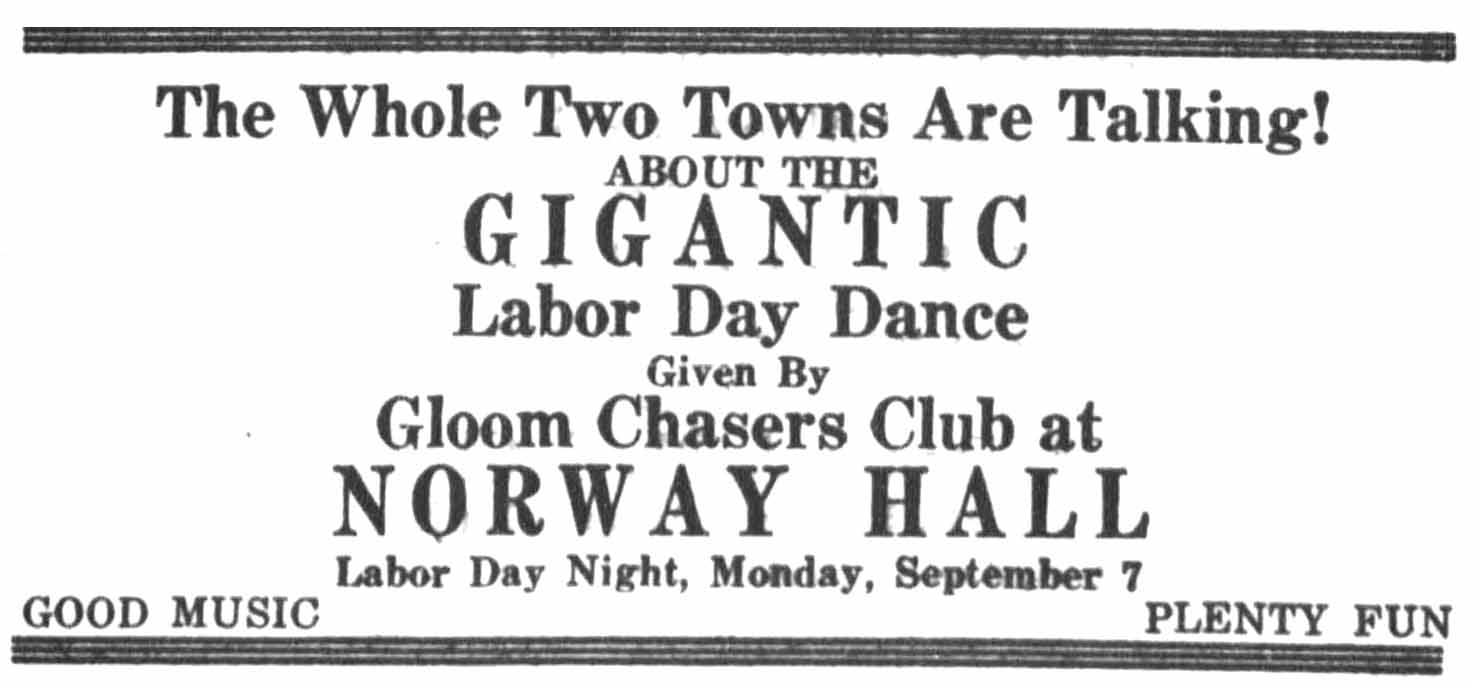
Minneapolis Spokesman, 1936
The Spokesman gave much publicity to the appearance of Nat Towles and His 14 Southern Gentlemen, who performed on September 29, 1936.
In its article about the Towles show, it said:
Norway Hall.. is one of the nicest halls in Minneapolis. It is centrally located, Selby-Lake street cars run within one block of the hall, making it convenient for St. Paul patrons who want to use the street cars. Chicago-Penn and Chicago-Fremont cars run right to the door. (Minneapolis Spokesman, September 25, 1936)
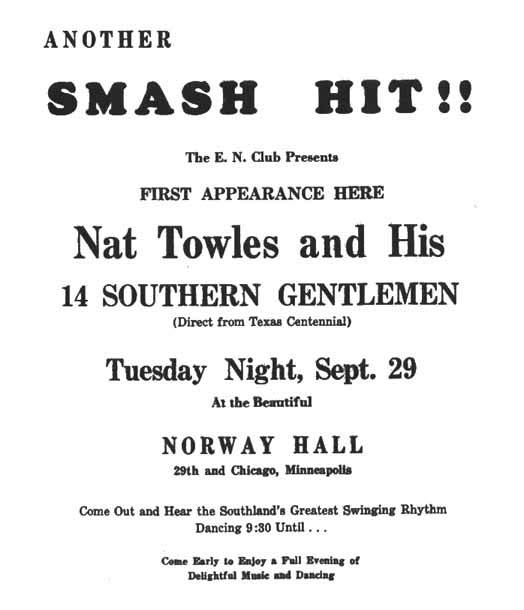
Minneapolis Spokesman, 1936
1937
Jimmie Slemmons presented this next event. Slemmons would later become a three-time “Mayor of Bronzeville” in the ’40s. On May 10, 1937, he presented a fantastic Battle of Music, pitting Boyd Atkins and his famous Cotton Club Orchestra (this was the St. Louis Park Cotton Club) against Gordon Parks’ Chicago Savoy Orchestra. It was billed as the Battle of the Century, and it probably was! Proceeds of the dance went to a fund for “a picnic for the children of unemployed colored families with the assistance of business firms in the city.” (Minneapolis Spokesman, April 30, 1937)
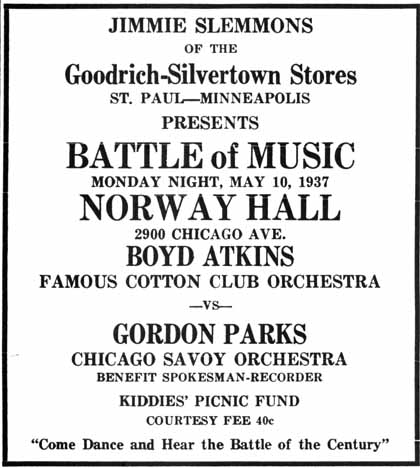
Minneapolis Spokesman
This one’s so good, let’s have two ads:
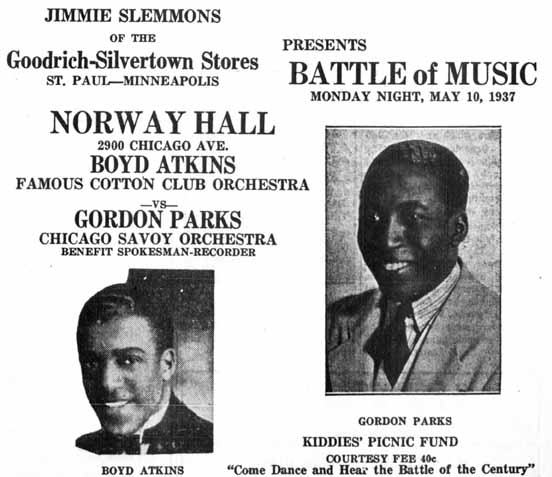
Minneapolis Spokesman
1938
On Valentine’s Day, 1938, a Gala Dance was given by the Twin City Division of the Brotherhood of Sleeping Car Porters, with music by Rook Ganz and His Band.
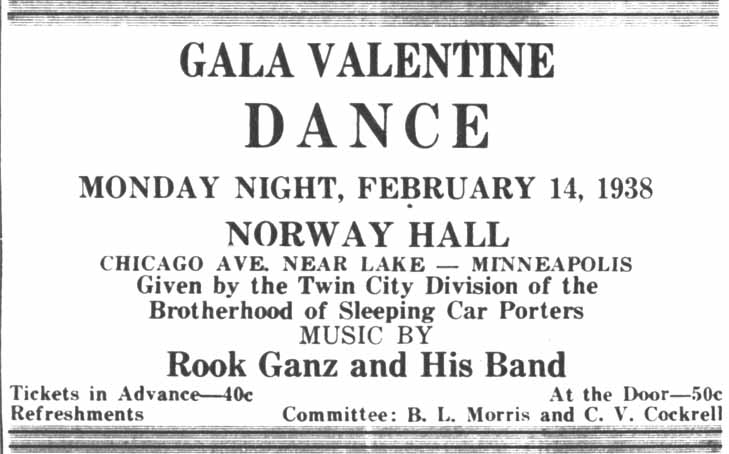
Minneapolis Spokesman
1939
1939 brought Doc Payne, King of the Sax, and His Recording Orchestra to Norway Hall on May 22. The band, direct from the Rex Rose Room in St. Louis, featured “Bubber” Kitson at the piano. A floor show was also on the ticket. (Does a floor show mean showgirls?)
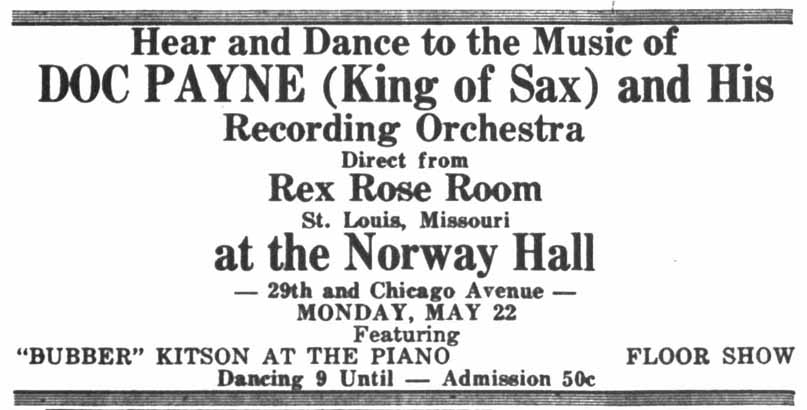
Minneapolis Spokesman, 1939
1945
As above, dances slowed down or stopped during the War. Next one found was when the Ames Lodge No. 106, Improved Benevolent Protective Order of Elks of the World, gave their Elks Grand Ball at Norway Hall on March 2, 1945. Music was provided by Walter Lear’s Gents of Rhythm. Popularity contests were common at these dances and balls – I’d love to know how they were carried out!
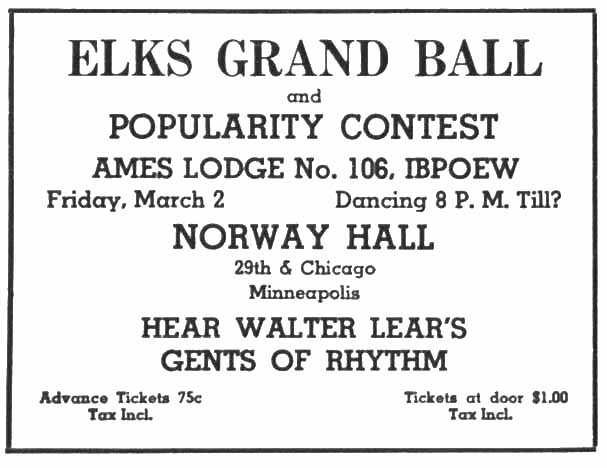
Minneapolis Spokesman, 1945
A Grand Halloween Ball was given by the Ames Lodge 106 and Minnehaha Temple No. 129 of the Improved Benevolent Protective Order of Elks of the World in 1945. Music was provided by Sir Walter Lear and His Rhythmeers.
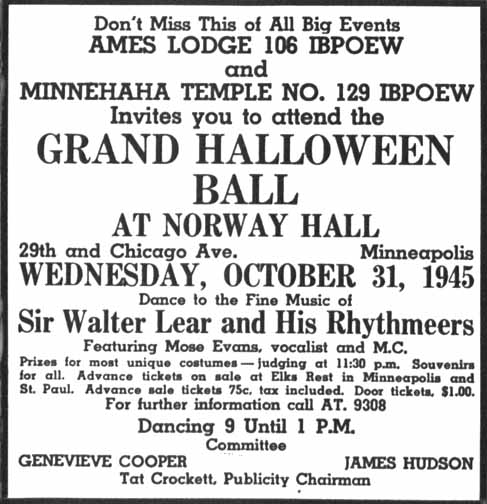
Minneapolis Spokesman
An Armistice Day Frolic was hosted by Johnnie Baker American Legion Post 291 and Women’s Auxiliary on Monday, November 12, 1945. All returning veterans in uniform were admitted for free. Music was provided by Howard Brown and His Rhythm Kings.
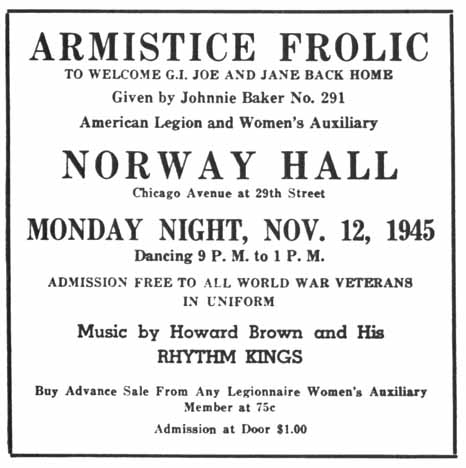
Minneapolis Spokesman
1946
Brutus Cassius sponsored an Armistice Day Dance on November 11, 1946, noted to be “Cabaret Style.” The ad is too blurry to post, but the musicians included:
- Percy Hughes and his Ex-Navy Band
- Judy Perkins, Pleasing Vocalist
- David “Duffy” Goodlow, Dynamic Trumpeter
- Bobby Crittenden, “Mr. Drums”
- Frank Lewis, “Noted Arranger and Tenor Sax”
Brutus Cassius sponsored a Pre-Season Holiday Dance on December 1, 1946, with the same line-up as his Armistice Day Dance of the previous November:
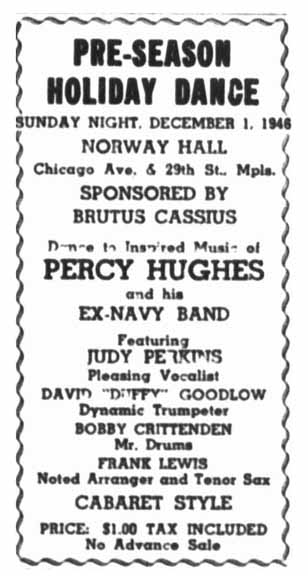
Minneapolis Spokesman
1956
There’s a note that Chuck Berry played at Norway Hall in April 1956. It appears that all regular dances seem to have ended for everyone at Norway Hall in 1956 for some reason.
GOPHER HALL
The next milestone is approximately April 1961, when the building was apparently sold to the Veterans of Foreign Wars Gopher Pup Tent No. 2 and became known as Gopher Hall for the rest of its life.
There are very few indications of public events, other than some square dances held by the VFW in March 1967.
NORWAY/GOPHER HALL BURNS DOWN
The building went down in a blaze on January 20, 1992. Unlike the old days of multiple news articles and photos, the papers published one photo with a caption. The building was described as “vacant,” which could mean that nobody was in it at the time, or that it had been abandoned. The fire started in the basement at about 9 pm at took 45 firemen to subdue.
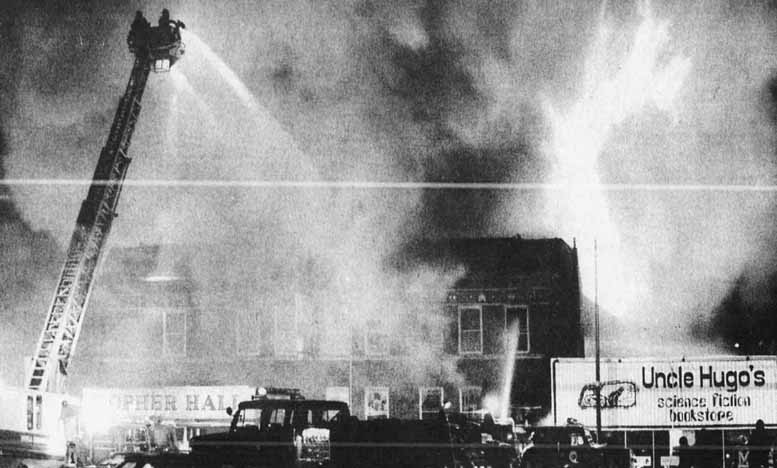
Minneapolis Tribune, January 21, 1992
Nye’s, at 112 E. Hennepin Ave. in Minneapolis, began as a bar called Hefron’s. Al Nye bought the bar in the late 1940s, and in 1964 he bought the place next door and opened the Polonaise Room Restaurant. Nye’s featured polka music in the bar and a piano bar in the front of the restaurant. 1969: The Nightcaps with go-go girls.
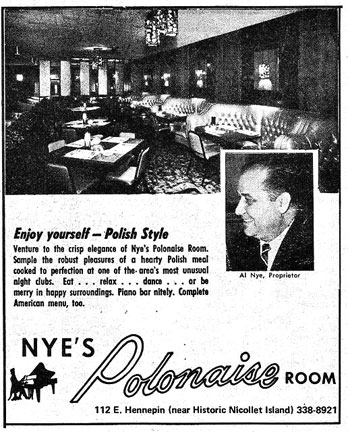
The I.A. O’Shaughnessy Auditorium is located at 1920 Randolph Ave., on the campus of the College of St. Catherine’s University in St. Paul. St. Catherine’s is one of the largest private women’s universities in the country.
The auditorium is named for former St. Catherine University trustee and benefactor I.A. O’Shaughnessy. It was designed by Minneapolis architect Curt Green in the Brutalism style, using concrete, but tempering the harsh unfinished look with redwood doors and sheets of glass.
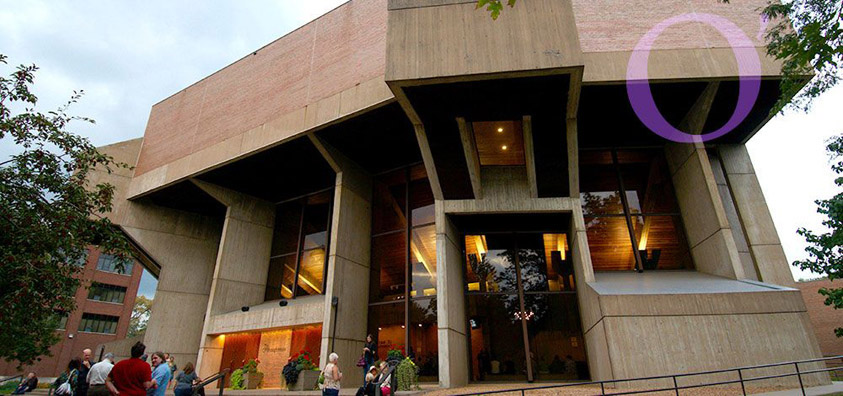
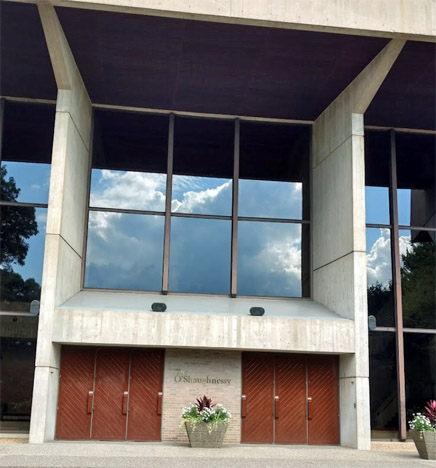
Inside there was an 1,804-seat proscenium stage theater. The stage is 52’ wide, 24’ deep, and 4 stories high. There are 20 or so adjustable acoustical panels in the ceiling.
The seats recline and the aisles are on the sides only, described as “continental style.” When it opened, in pure ‘70s style, the seats were in alternating rows of orange, red, magenta, and purple.
The space was designed to be adapted to a 600-seat space by lowering the ceiling of the venue, shutting off the balcony. In comparison, Northrop Auditorium, at the University of Minnesota, has 4,800 seats, which can be a lot of seats to fill. O’Shaughnessy is also more intimate than the 2,700-seat St. Paul Auditorium. And it was superior to the Guthrie, with 400 more seats, better acoustics, and a setting built for concerts, not for plays.
The new hall was dedicated by the Minnesota Orchestra on October 1, 1970. Appropriately, the Orchestra played Beethoven’s “Consecration of the House Overture.” The Minnesota Orchestra immediately became one of the most frequent users of the auditorium, alternating between O’Shaughnessy in St. Paul and Northrop in Minneapolis.
Other groups that appeared frequently in the early days before Orchestra Hall was built in 1974 were:
- The Mozart Festival
- The St. Paul Opera
- The St. Paul Chamber Orchestra
- The Schubert Club
- The Bach Society
In addition, the auditorium was used for recitals, dance, theater, lectures, choirs, and films.
POPULAR CONCERTS
A newspaper search turned up several non-symphonic concerts, and 99 percent of them would fall into the “mellow” category. The following is a list of the pop concerts found from 1971 through 1974 (the end of this website). Please Contact Me if you know of any more or if you have any stories!
GYPSY WITH COPPERHEAD
Gypsy with Copperhead, January 10, 1971. These were the two rock groups to play the hall, and according to reviewer Jim Gillespie, the venue was better suited to acts such as John Sebastian than to hard rock. Gillespie noted the understaffed ticket office, which caused people to stand in line and the concert to start 45 minutes late.
Gillespie found the music “rather disappointing.” Copperhead was an eight-man horn band whose musicianship was at a high level, but their original material was, “for the most part, bland and uninspired. They did a lot of jamming but only seldom did anything worthwhile come together.
Gypsy had released their first [eponymous] album a few months ago, and had been playing places like the Fillmore East in New York, where they were very well received.
The music is a successful blend of hard rock and softer, almost jazz-like strains. Their strongest point is the soaring harmony the vocalists have worked out. At times they sound almost as sweet as CSNY. They are all good musicians but the lead guitarist was the outstanding and he doubled on flute and piano also. (Minneapolis Star, January 11, 1971)
One source says that Gypsy returned on February 4, 1971, but I couldn’t find it again.
ALLMAN BROTHERS
The Allman Brothers, with the Litter, March 25, 1971 (two shows)
Both Jim Gillespie (Minneapolis Star) and Scott Bartell (Minneapolis Tribune) published gushing reviews for this show on March 26, 1971. In fact, Gillespie was afraid his review was going to sound like a paid advertisement.
The six piece band members were:
- Jai Johanny Johanson: Drums
- Butch Trucks: Drums
- Duane Allman: Guitar, slide guitar
- Dicky Betts: Guitar
- Berry Oakley: Bass
- Gregg Allman: Organ, Piano, Vocals
Gillespie couldn’t say enough about the the talent of the band:
Allman’s guitar playing is absolutely astounding. I’ve seen Clapton, Hendrix, B.B. King and just about everybody else recognized as a top guitarist, and when Allman is play well, none of them can touch him. . . On the first song [Statesboro Blues], he was hitting notes that other people do not seem to have discovered yet, and he got better as the concert progressed. The second show must have really been a knockout.
One big problem was that the public address system was severely malfunctioning, intermittently cutting off the vocalist’s microphone and making it impossible for Gregg to sing.
Also, a sad note on Gillespie’s review, when he wrote, “it boggles the mind to think of where they will be a year from now.” Duane Allman died in a motorcycle crash just seven months after this show, and bassist Berry Oakley died in November 1972. The band went on, but without their amazing talent.
Reviewer Bartell noted that the band played “Someday Baby,” an unnamed sixth piece that lasted 20 minutes, and their final number, “You Don’t Love Me, Baby,” also 20 minutes. PA problems prevented an encore, but “lack-luster” emcee Marilyn from KQRS was unable to explain because her microphone was dead as well.
Bartell did write about the opening act, the Litter, who also got the raw end of the sound system, wasting a lot of their time.
As I remember, they used to be more interesting – now they just seem affected, especially on their farther-out numbers. . . . Their last song, an original piece of pseudo-Fifties rock ‘n’ roll called “Ozone,” was pretty good, though, and they got through it all right.
QUICKSILVER MESSENGER SERVICE
Quicksilver Messenger Service, with Brewer and Shipley, April 7, 1971 (2 shows). Brewer and Shipley also played on April 29 at the Whole Coffeehouse at the U of M. No review found.
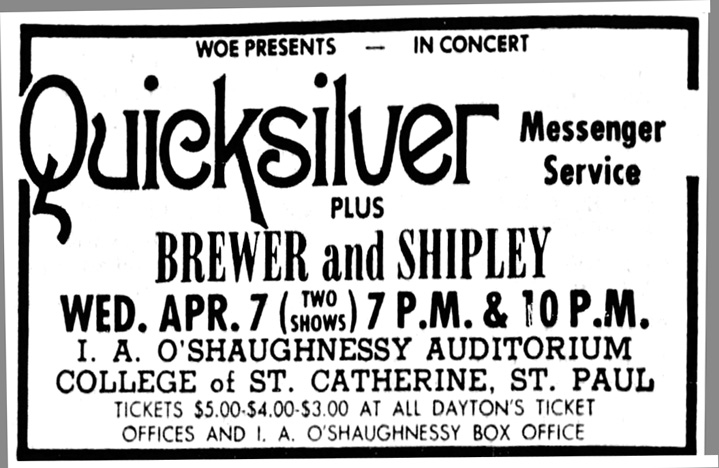
Minneapolis Tribune, March 28, 1971
John Baldry with Madura, September 19, 1971. No review was found.
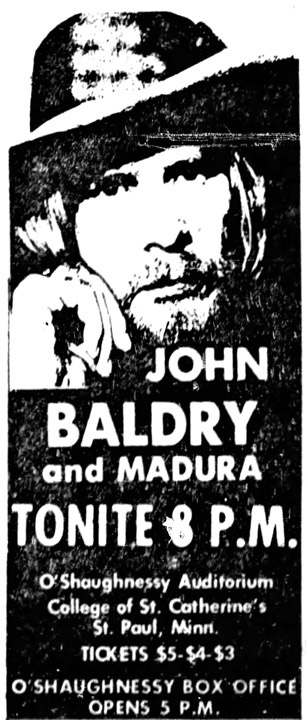
Minneapolis Tribune, September 19, 1971
Don Ellis and Friends appeared at O’Shaughnessy Auditorium on September 25, 1971. Advertised in Minneapolis Tribune, September 19, 1971. No review found.
Crow and Willie and the Bumblebees, October 18, 1971. (Insider music calendar, October 1971)
The Insider advertised that Roberta Flack would appear at the O’Shaughnessy Auditorium on November 6, 1971 for two shows, but there is no evidence in the Minneapolis newspapers that this actually happened.
PENTANGLE
Pentangle was at the O’Shaughnessy on November 28, 1971. No review found.
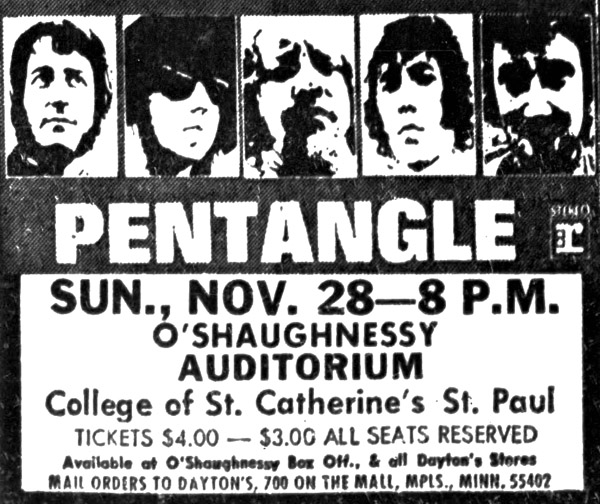
Minneapolis Tribune, November 14, 1971
THE SWINGLE SINGERS
The Swingle Singers performed with the Minnesota Orchestra on November 11, 1971.
The Swingle Singers formed in 1962 in Paris by American Ward Swingle. The group consisted of eight session singers who put out albums of Classical and jazz, rendering them five Grammy awards. In 1973, Swingle disbanded the original French group when he and his family moved to England. (Wikipedia)
Swingle believed that the human voice was the “first and best of musical instruments.” (Minneapolis Star, November 10, 1971)
The work presented was an avant-garde composition called “Sinfonia,” by Luciano Berio, written for the Swingle Singers in 1968. The Swingles were apparently known for use of unusual vocal effects. “Sinfonia’s” five movements could be a “source of puzzlement” to one listener, and “just plain annoyance” to another, noted reviewer Mike Anthony (Minneapolis Tribune, November 12, 1971). Anthony himself found it “totally engrossing,” more so after each hearing.
The third movement featured the text from Beckett’s “The Unnamable,” read by Swingle himself. The fifth movement was added later, and Anthony found it to be the least satisfying – “much more diffuse and unstructured than the rest.”
A symphony was performed after the intermission, but the Swingle Singers were not mentioned as participants.
1972
GORDON LIGHTFOOT
On January 23, 1972, Gordon Lightfoot performed two sold-out shows. It was his third appearance in the Twin Cities, the first to being at the Guthrie in 1970 and 1971. The 1972 shows were promoted by Music Sphere Productions (Fred Krohn).
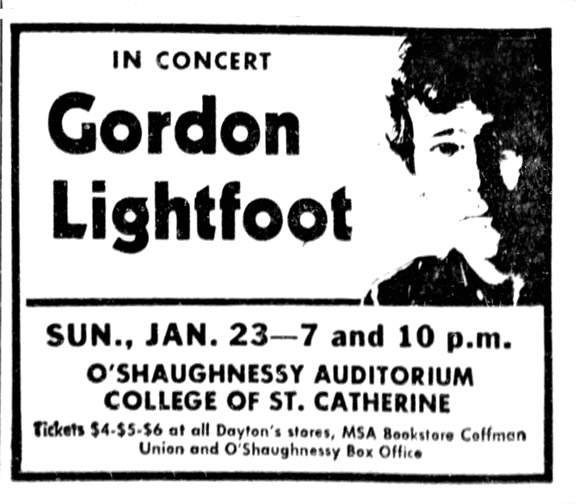
Minneapolis Tribune, January 16, 1972
Lightfoot’s sidemen were Rick Haynes, his usual bass player, and Terry Clements, who replaced Red Shea on lead acoustic guitar.
Glenn Elvig was at the concert and wrote:
I had finished an interview with Gordon earlier in the day as part of my radio gig at WMMR [U of M campus radio.] Then…thanks to Fred Krohn, who was promoting Lightfoot at the time….and all time after that as well….I had a wonderful seat backstage. Again, forever thanks, Fred.
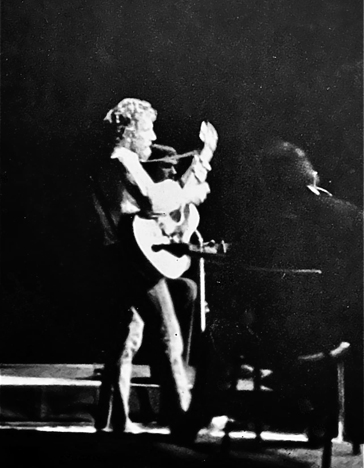
Photo courtesy Glenn Elvig
Peter Altman of the Minneapolis Star (January 24, 1972) reported that Lightfoot (sporting a new “russet beard) introduced several new songs from his upcoming album, “Don Quixote,” due out soon.
Songs performed included:
- Susan’s Floor
- Ode to Big Blue
- Through the Hills and Through the Valleys
- You’re Beautiful
- Ten Degrees and Getting Colder
- Canadian Railroad Triolgy
- Pony Man
- Miguel
Altman was “mildly dissatisfied;”
There was nothing flagrantly wrong with any of the songs, but a sense of occasion and committed involvement sometimes was lacking. There was a tendencey, encouraged by the fact that his manner is always low-pressure, to think at times, that Lightfoot was only going through the familiar motions.
M. Howard Gelfand of the Minneapolis Tribune (January 24, 1972), however, found Lightfoot’s performance “quiet, even, predictable, but thoroughly professional. No disappointments, no surprises.
While Altman’s complaint about the sidemen was that the new guitar player was not as good as the old one, Gelfand noted that they were seated in near darkness, were not introduced until the end of the concert, and although they provided vocals, they were not provided microphones.
Gelfand also noted that while Lightfoot could “toss off a few one-liners between songs, [he] seems incapable of humor or irony in his lyrics. Lightfoot also went off on a “rambling jive” on the plight of the endangered whale, which confused the audience and was met with “confused laughter.” This ended with a song about Moby Dick.
Both reviewers had nothing good to say about the husband and wife opening act, Kris and Dale O’Brien. While Altman kindly just called them “dull,” Gelfand really tore into them, calling them:
folksingers who represent all that I’ve always found repugnant in folk music – wasteful arrangements, melodramatic voices, stagey dynamics, unoriginal interpretations of “old standards,” even Edwardian costumes. They were accompanied by Mas Swanson, whose delightful, soaring flute was sated amidst such pap.
DELANEY AND BONNIE
Delaney and Bonnie and Friends, with Kevin Odegard and Friends, February 22, 1972. This was Delaney and Bonnie’s second appearance in the Twin Cities – they had been here for Open Air I in 1971.
Although this concert was billed as Delaney and Bonnie and Friends, the “and Friends” concerts featuring such luminaries as Eric Clapton were behind them. In fact, this was one of Delaney and Bonnie’s last concerts, as they divorced in 1972.
Reviewer Roy M. Close (Minneapolis Star, February 23, 1972) wrote that, from their records he expected a combination of blues, gospel and rock that characterized Delaney and Bonnie’s music. He found instead that they were more influenced by jazz than he had realized.
What really disturbed him was the volume of the concert, which, on a decibel scale, was “somewhere between the buzz of a chain saw and a jet take-off.” No lyrics could be heard, and at times it was difficult to determine what songs were being sung.
Contributing to volume was the powerful seven-piece backing band, which included:
- Trumpet
- Trombone
- Saxophone
- Electric Organ
- Drums
Delaney Bromlett sang and played guitar.
Kevin Odegard’s band was made up of Stan Kipper, Andy Howe, Greg Anderson, Dick Hiebeler, and Larry Ankrum. Close’s review said that the group’s lead singer’s name was announced as “Kevin Overgard.” He didn’t do the group any favors with his review:
Although its drummer and bass guitarist played with reasonable dexterity, for most of its short set the group looked nervous and sounded out of tune.
Early times.
PETER YARROW
Peter Yarrow, March 18, 1972. This was his first concert on his first major tour since Peter, Paul, and Mary split up. It was a benefit for Youth Citizenship and American Indian Funds for St. Catherine’s. (Minneapolis Star, March 16, 1972) No review found.
Leo Kottke, May 27, 1972. (Insider music calendar, May 1972) (no newspaper matches)
PETER YARROW
Peter Yarrow, formerly of Peter, Paul and Mary, gave a benefit performance on October 2, 1972 with local entertainer Cyril Paul. Proceeds went to the International Assembly of Christians in Solidarity with the Vietnamese, Laotian and Cambodian Peoples. Between the time PPM broke up in 1970 and October 1972, Yarrow had made more 400 free appearances for social concerns, peace rallies, and voter registration drives. (Minneapolis Tribune, October 2, 1972)
No review found.
JUDY COLLINS
Judy Collins, December 6, 1972, presented by Fred Krohn. Two shows. Reviewer Peter Altman found Judy to be less guarded and more free and relaxed than she had been in previous shows.
She played guitar and piano, and was accompanied by:
- Richard Bell, piano
- Gene Taylor, bass
- Susan Evans, drums
Songs included:
- City of New Orleans
- The Fishermen Song, which she accompanied herself on the autoharp
- The Hostage
- I Always Cook With Honey
- Secret Gardens of the Heart
- She is a Weaver
- In My Life
- Both Sides Now
- Open the Door
- Someday Soon
- My Father
- Suzanne – solo
Altman:
Maybe Ms. Collins artistic self-expression the past few years has had a liberating effect on her; perhaps something else lately has lit her up. At any event, she was splendidly vital and together yesterday – and still absolutely scrupulous about her craftsmanship. Her performance could scarcely have been more gratifying. (Minneapolis Star, December 7, 1972)
One anecdote: Dave Ray opened but was not introduced. After showered with boos, it was announced that the performer was indeed Snaker Ray, and the audience was stunned.
1973
MARY TRAVERS
Mary Travers and Jesuit Priest Daniel Berrigan, January 14, 1973 – an Evening of Poetry and Music. Benefit for the International Assembly and Berrigan’s Defense Fund. Berrigan had served time in prison for his radical non-violent protest of the Vietnam War. No review found.
GORDON LIGHTFOOT
Gordon Lightfoot performed two sold-out shows February 11, 1973.
Reviewer Marshall Fine opined that although Lightfoot had reached his creative peak about two years ago, he was only discovered by the public at that time. So as his popularity has grown, his creativity has declined.
This is not to say that Lightfoot is a less-than-adequate performer. There is still the feeling of despair and poignant despondence which his songs communicate so well. He still produces interesting images and paints vivid word and music pictures and melodies.
But music was changing and Fine wrote that Lightfoot lacked vitality – had not stayed fresh. Fine was comparing him to Elton John and Carly Simon, and calling Lightfoot slightly anachronistic, not coming out of the sixties into the seventies.
Fine did have much more praise for the opening act, the Muledeer and Moondogg Medicine Show. These were two young men from South Dakota, one of which had to have been the comedian Gary Mule Deer. They “had the audience laughing loudly at references to drugs, sex and religion.” (Minneapolis Star, February 12, 1973)
KRIS KRISTOFFERSON AND RITA COOLIDGE
Kris Kristofferson and Rita Coolidge, March 31, 1973 (two shows). Both shows had been sold out for ten days.
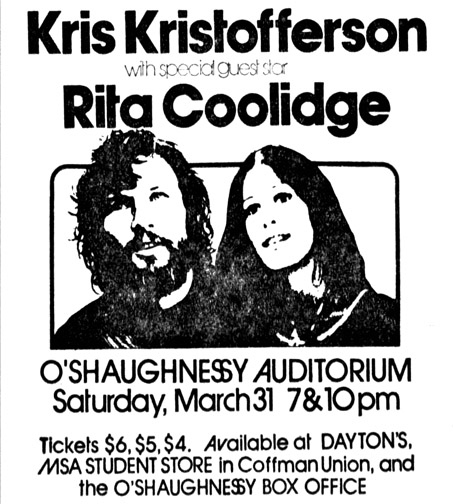
Minneapolis Tribune, March 11, 1973
Bad weather in Chicago forced the first show to start one hour late, but he stayed for and hour and 45 minutes.
Kristofferson’s songs included:
- The Late John Garfield Blues
- Out of Mind, Out of Sight
- Jesus Was a Capricorn
- Okie From Muskogee
- Sunday Mornin’ Comin’ Down
After the first hour he brought out Coolidge and they sang:
- It Sure Was Love
- Me and Bobby McGee (finale)
- Billy the Bum (John Prine)
- My Crew
- Help Me Make it Through the Night
Coolidge sang alone:
- Fever
- A Woman Left Lonely
- I’ll be Your Baby Tonight
There were five sidemen, including:
- Stephen Burton: Guitar
- Terry Paul: Bass
Reviews:
- Roy M. Close, Minneapolis Star, April 2, 1973
- Michael Anthony, Minneapolis Tribune, April 2, 1973
ERIC WEISSBERG AND DELIVERANCE
A show called “Dueling Banjos,” starring Eric Weissman and his band Deliverance, was presented on May 4, 1973.
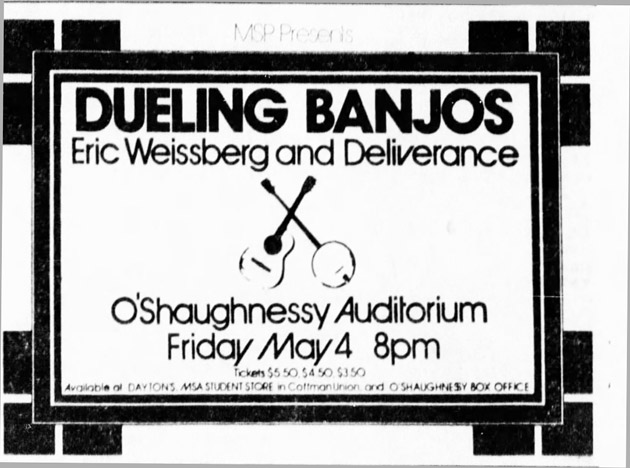
Minneapolis Tribune, April 15, 1973
The Back Story
The song “Dueling Banjos,” from the movie “Deliverance,” had a local connection. Allen Abrams, sales director of Warner/Elektra/Atlantic Records for the Minneapolis region, heard the song in his car in October 1972, but his promotion staff didn’t have it. He called WCCO and found that it was a promotion record sent out by Warner Bros. films. Abrams called Warner Bros. to see if they were going to release it, and told them he could sell 4,000 or 5,000 copies. The guy at Warners said “That’s the worst piece of crap I ever heard,” but agreed to release it. Abrams’ promotion staff had to get WCCO to keep playing their copy of the record until stock arrived.
Abrams suggested that Warner Bros. come up with an album, and thought that John Hartford could do it, but Warners found an album on Elektra by Eric Weissberg and Steve Mandrell. They leased the album from Elektra, changed the cover, and that became the Dueling Banjos album. The single was certified as over a million seller, and the album was certified as earning over a million dollars. (“The Making of a Record,” Connie Hechter, The Insider, July 1973)
For its role in selling a million records for Warner Bros, WCCO was awarded a gold record. An article in the Minneapolis Tribune’s TV Week (June 3, 1973) reported that Denny Long, the station’s music director, had discovered the record and urged its play. Among those who played it were Roger Erickson, Chuck Lilligren, and Howard Viken. The gold record was presented by Warner Bros. representatives Abrams and Cliff Siegel.
The Concert
Concert reviewer Marshall Fine noted that the group had only been together a month and a half, and had yet to determine a focus for the band – was it bluegrass or country & western? Each 30 minute concert was half and half.
Musicians included:
- Weissberg on banjo and pedal steel
- Charlie Brown, lead guitar
- Steve Mandell, rhythm guitar
- Tony Brown, bass and vocals
Fine found the country songs lacking in life and slow in pace, but he gave high marks to Weissberg’s banjo playing and Brown’s guitar.
[Addendum:
31 years later, Weissman would recreate the moment, this time with Peter Oshtrushko at the Pantages Theater on February 3, 2004.
The song was actually written by Arthur “Guitar Boogie” Smith in 1955, and he sued when he was not credited as the author.]
Opening the show was local singer Ted McGill, “who offered a half-hour of pleasant, if somewhat ordinary, singing and some good acoustic and electric slide guitar playing.” (Minneapolis Star, May 5, 1973)
JOHNNY SMITH
Guitar player Johnny Smith performed on October 5, 1973. Smith was a cool jazz and contemporary guitar player who wrote “Walk, Don’t Run” in 1954. The show was a benefit for the Scoliosis Research Fund. (Minneapolis Tribune, October 5, 1973)
TONY BENNETT
Tony Bennett graced the O’Shaughnessy stage on October 12 and 13, 1973, singing the songs of Rodgers and Hart. Both shows were sold out.
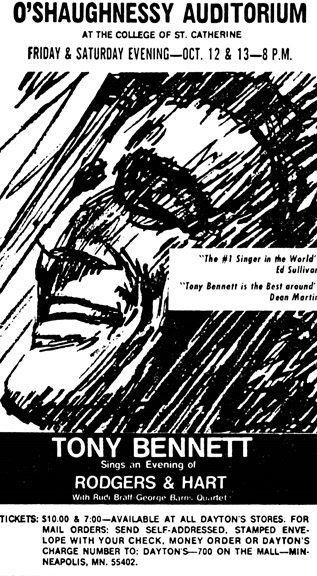
Minneapolis Star, October 10, 1973
Bennett was backed by the Ruby Raff (trumpet) – George Barnes (guitar) Quartet.
Songs included:
- Blue Moon
- The Lady is a Tramp
- Mountain Greenery
- Thou Swell
- I Left My Heart in San Francisco – encore
Reviewer Marshall Fine noted that Bennett was rather non communicative, saying little between songs. He also noted that the 60-minute show was rather short. (Minneapolis Star, October 13, 1973.)
JUDY COLLINS
Judy Collins, October 19, 1973 (two sold out shows)
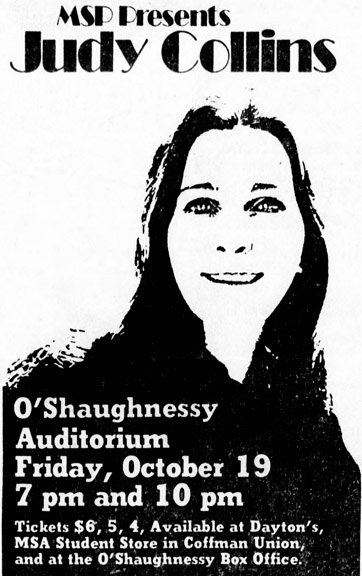
Minneapolis Tribune, October 9, 1973
Reviewer R. M. Close (Minneapolis Star, October 20, 1973) wrote that the first show was 90 minutes long, and Ms. Collins concentrated on her latest album, “True Stories and Other Dreams.” Songs included:
- The Hostage
- The Fishermen Song
- Song for Martin – accompanied by autoharp
- Holly Ann
- Suzanne
- Both Sides Now
- City of New Orleans
- Chelsea Morning
- Who Knows Where the Time Goes
Judy played the piano and 6- and 12-string guitar, in addition to the autoharp. Her band consisted of:
- Richard Bell, piano
- Mark Horowitz, pedal steel guitar
- Gene Taylor, bass
- Don Brooks, harmonica
- Bo Siegel, drums
- Steve Mandel, guitar
KRIS KRISTOFFERSON
Kris Kristofferson performed two sold out shows on November 30, 1973.
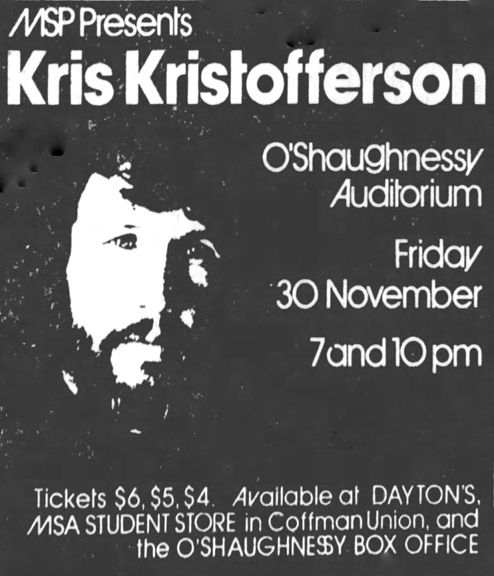
Minneapolis Tribune, November 11, 1973
Usually appearing with his wife Rita Coolidge, this time Kris was on his own, and the show was a “flop,” according to reviewer Roy M. Close. Most of the problem was that his voice grew increasingly hoarse, so by the end of the first show, “Help Me Make it Through the Night” took on a new meaning. There were also problems with the sound equipment, and Close felt that members of his band, two of which were new, did not play cohesively. Kris’s apology for how badly he felt about it all was an “unpardonable mistake,” opined Close, and “never improves matters.”
Songs included “Out of Mind, Out of Sight” and “Searching.”
At the point in the show where he normally would have brought Rita onstage, he introduce a young singer named Bob Neuwirth, who sang humorous songs, including a parody of “Vincent,” and an “overly loud rocker.” Then KK’s pianist, Donnie Fritts, sang a couple of his own songs. (Minneapolis Star, December 1, 1973)
1974
Ian And Sylvia were booked by Fred Krohn for January 18, 1974, but cancelled for personal reasons.
NEW BIRTH AND THE MYSTICS
New Birth, opened by the Mystics, performed on February 11, 1974. New Birth was an R&B band and the Mystics were a longstanding popular local band.
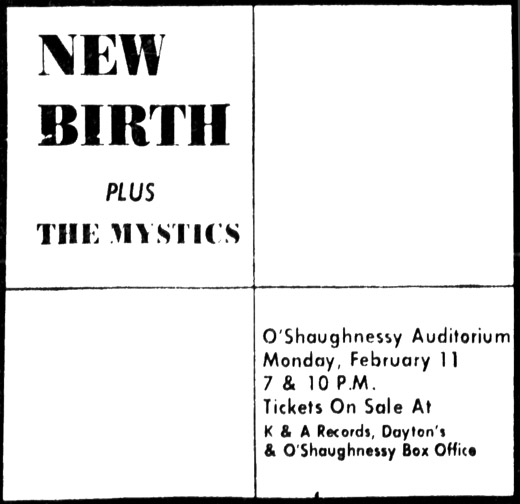
Minneapolis Tribune, February 3, 1974
GORDON LIGHTFOOT
Gordon Lightfoot’s two shows on February 17, 1974, filled up so fast that a third show was added the next night, February 18, (Presidents’ Day) at 7:30 pm.
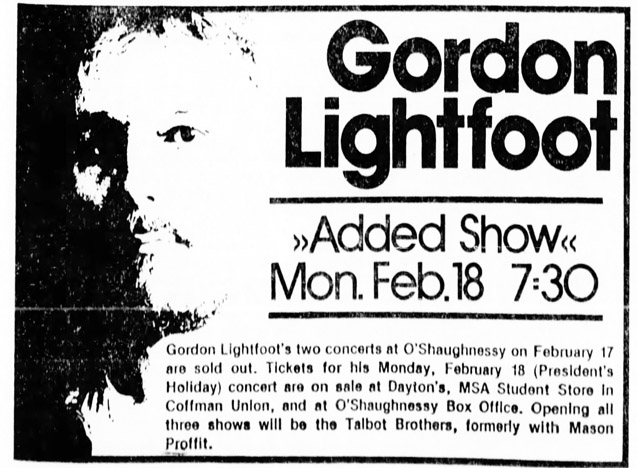
Minneapolis Tribune, February 3, 1974
Charles Quimby reviewed the concert for the Minneapolis Star (February 8, 1974), providing us with some details. He wrote that Lightfoot drew about equally from his past repertory and his latest album, “Sundown.” Although he made efforts to establish rapport with his audience, it was his songs that enthralled the crowd.
Songs performed included:
- If You Could Read My Mind
- Ten Degrees and Getting Colder
- You’re Beautiful (which to Quimby sounded similar to If You Could Read My Mind)
- The Auctioneer
- Divorce Country Style
Lightfoot’s sidemen were Terry Clements on lead acoustic guitar and Richard Haynes on bass, providing “capable and unobstrusive instrumental and vocal support.”
The opening act was a 40-minute set with the Talbot Brothers, former members of Mason Profitt.
Quimby:
Their performance featured harmonies and guitar work which were pleasant enough, but in contrast to Lightfoot’s, their lyrics were pallid and sometimes ludicrous.
Michael Anthony of the Minneapolis Tribune (February 19, 1974) reviewed the Sunday night Lightfoot show, and found the music “totally engaging and professionally done.” He noted that the stage was decorated with potted ferns, and that Lightfoot “seemed as potted as the ferns” – both reviewers noted that he looked like he had been drinking, and he admitted it on stage.
His set was 70 minutes long, and in addition to the songs listed above, he sang:
- Cotton Jenny
- Alberta Bound
- Canadian Railroad Trilogy (closer)
- Sundown
Anthony reveals the names of the Talbot Brothers to be John and Terry.
It might be argued that the type of music they do – “Goin down-to-Jordon-the-Indian-gotta-hammer-in-his-hand” – is too much of the full-voiced, socially conscious but dated folk music of the late 1950s and early 1960s. But the Talbots have very good voices. And you never know what kind of music is just around the corner.
HERBIE MANN
Flutist Herbie Mann, with David “Fathead” Newman performed two identical benefit shows on March 1, 1974. The concerts were benefits for the St. Paul Chamber Orchestra.

Minneapolis Tribune, February 24, 1974
Herbie Mann was perhaps the most widely recognized flutist in the country, wrote reviewer Charles Quimby (Minneapolis Star, March 2, 1974), making nearly 50 albums by 1974 and almost single-handedly legitimized the flute as a jazz instrument. The appeared with a seven-man ensemble, including Tony Levin on bass and Sam Brown on guitar. David Newman played tenor sax. In addition to the drummer, there was a second percussionist who was in charge of bells, chimes, and a gong.
Songs included the familiar “Push-Push,” but also the Rolling Stones’ “Bitch. Musicians took solos on numbers called “The Nighttime is the Right Time” and “Sunrise High.”
ANNE MURRAY
Anne Murray, March 8, 1974, 8pm
Murray had been in the Twin Cities before, supporting Bobby Goldsboro in a Grandstand show at the 1972 State Fair, but this 1974 show was her first major concert on her own, and she drew a capacity crowd. Although she drew a standing ovation, and reviewer Peter Altman found her to to be exceptionally youthful and fresh, he also found a number of “consequential flaws.”
She was backed by a seven-man band called Richard, which included:
- Trombone
- Saxophone
- Flute
- Guitars
- Piano
- Electric bass
- Drums
Plus six string players.
The show started with a half-hour set by Richard, played without much dynamism, according to Altman. All these players slowed the momentum and got in the way of Murray’s singing. In all, the accompaniment was “excessive and not very interesting.”
In addition, Altman had a problem with Murray’s material. He said she has not figured out what to sing, and didn’t know how to package herself. Her material ranged from gospel blues to country to super-commercial pop. He called her material “bland” and “slick,” and her arrangements “fussily over-complex.” Many songs had a somewhat synthetic smoothness. (Minneapolis Star, March 9, 1974)
SANDLER AND YOUNG
Sandler and Young, April 5 and 6, 1974. No review found.
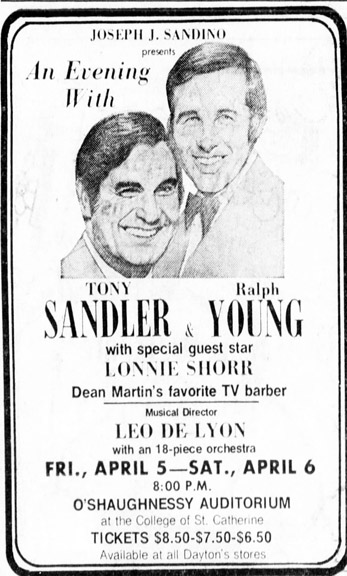
Minneapolis Tribune, March 31, 1974
UP WITH PEOPLE
Up With People gave two shows on April 20 and 21, 1974 (one show each day).
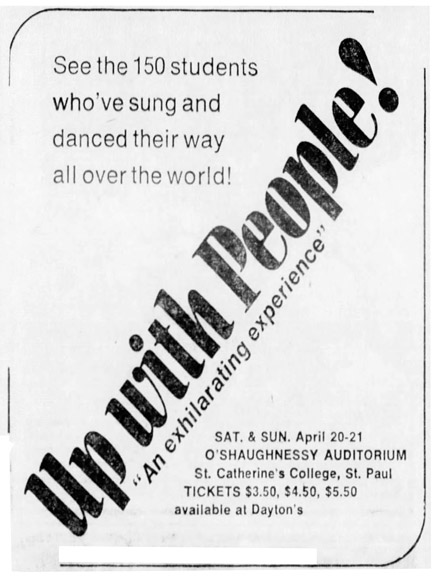
Minneapolis Tribune, April 7, 1974
Up With People was started by J. Blanton Belk in 1965 as a kind of clean-cut alternative to hippie protestors. Large casts put on shows all over the world at events like the Super Bowl and in front of world leaders. Members stayed with guest families as they traveled. Members were aged 17 to 25. The message of Up With People was that the world’s greatest natural resource is its young people.
This appearance was sponsored by Village Chevrolet. The group also performed a free mini concert on April 19 at 12:30. The cast of 110 singers, dancers, and musicians was one of three troupes traveling the country. The music combined folk, rock, country, and jazz. They traveled with seven tons of stage, lighting and sound equipment. Professors traveled with them as they continued their education, and they received accreditation through the University of Arizona. They were on the road 10 months out of the year. (article uncited)
Rod McKuen, , May 10, 1974, 7 & 10
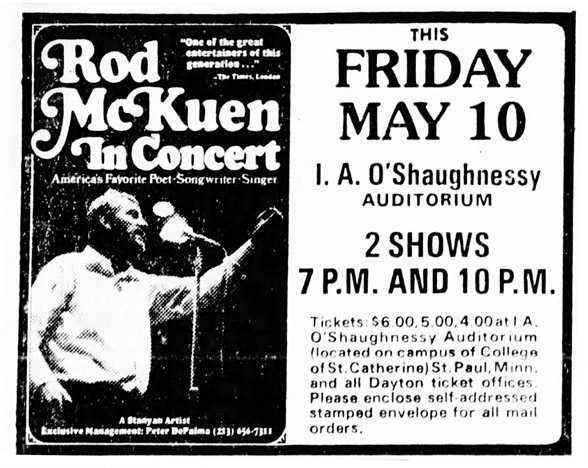
Minneapolis Star, May 9, 1974
DAVE BRUBECK AND SONS
Dave Brubeck and Sons Darius, Chris, and Dan with St. Paul Chamber Orchestra, May 14 and 15, 1974, 8 pm. Two different programs. $15/seat plus party with band after Wednesday’s show. Members’ Lounge of the St. Paul Arts and Science Center, 30 E. 10th Street, Downtown St. Paul. Benefit for the orchestra’s Musicians’ Annuity Fund.
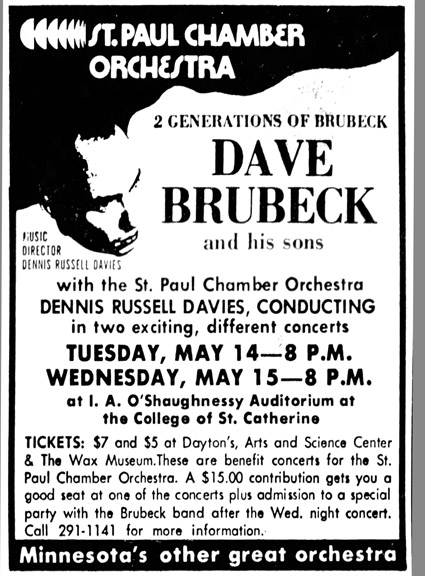
Minneapolis Tribune, May 5, 1974
EDDIE KENDRICKS
Eddie Kendricks, opened by Graham Central Station, May 16, 1974, two shows.
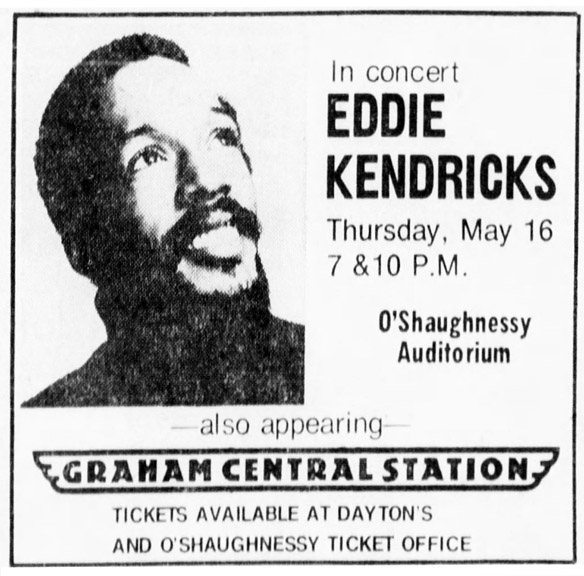
Minneapolis Tribune, May 12, 1974
Jon Bream, in his “R ‘n’ R Hootchie Koo” column in the TC Express magazine (July 1, 1974), reported that that there was a big problem, because Graham Central Station had just opened for Herbie Hancock at the Guthrie ten days earlier.
Most acts won’t come back to the same market for at least 30 days, and there are usually riders in their contracts with this stipulation. When this was pointed out to the agent, she asked, “Is St. Paul in Minnesota? Oh, I guess it is. Well, where is it?” “Across the river from Minneapolis.” “Oh.”
Again, Jon Bream:
First appearance by a major mainstream R&B act in the Twin Cities in more than a year. First time promoter Philip Fields should be commended for his efforts. The only glaring flaw was the woefully inadequate sound system; Graham Central Station sounded more together 10 days earlier doing the same material at the Guthrie. The young crowd, determined to party, seemed a bit insensitive (O aint no discoteque) to the nuances of Kendricks’ material, the highlight of which was an old Tempations’ medley. (Twin City Express, June 3, 1974)
BOBBY LYLE
Bobby Lyle and jazz group Skyle with St. Paul Chamber Orchestra, May 24, 1974, 8 pm. Bobby Lyle was an organist whose family moved to Minneapolis when he was one year old. He attended Macalester College in St. Paul. On June 17, 1973 he was named the Champion at the Yamaha Electone Organ Festival before over 2,000 in Chicago. He won $1,000 and an expense-paid trip to Japan in October 1973 to compete in the International Yamaha Electone Festival. In 1974, Lyle and his family moved to Los Angeles.
MARLENE DIETRICH
Marlene Dietrich was booked for two shows on May 26, 1974, 7 & 10, at a high (for the time) ticket price. Promoter Fred Krohn was reportedly paying her over $10,000 for the appearance.
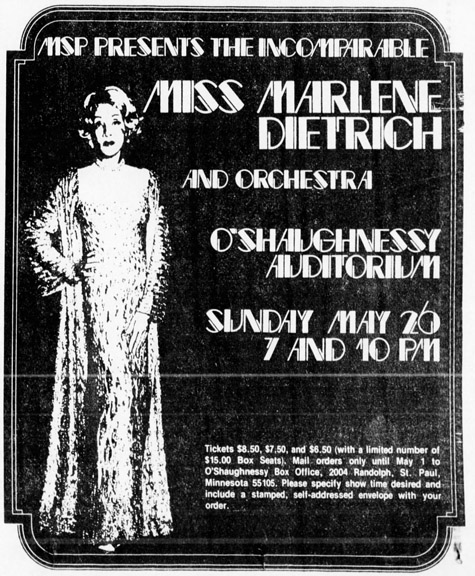
Minneapolis Tribune, April 21, 1974
The second show cancelled because only 200 tickets were sold, so chairs were brought in to accommodate those with tickets to the late show.
This was to be Ms. Dietrich’s first visit to the Twin Cities, said her agent. It was reported that she would wear a Paris-designed rhinestone and sequin dress, valued at $30,000 at her appearance. In addition, she would wear an ostrich cape with a train and artificial diamond jewelry. (Minneapolis Tribune, May 22, 1974)
Anthony described her dress as as “those same Jean Louis gowns (silver beaded) and the ubiquitous swansdown coat (she owns two, a $16,000 male and a $12,000 female).” He noted a slight limp from a previous fall. Close called it a “translucent sequined gown.”
Michael Anthony of the Minneapolis Tribune and Roy M. Close of the Star reviewed the show on May 28, 1974.
Both agreed that Dietrich really couldn’t sing:
Close:
Her tone is husky and thick, her sense of timing is weak, her range is quite limited, and she not infrequently sings out of tune.
But her lack of talent wasn’t the point.
Close again:
And what a triumph it was: a remarkable reaffirmation of the magnetism of Miss Dietrich’s public personality – an unforgettable amalgam of sophisticated sex appeal, grand style and superb control.
Anthony:
It’s rather the most impeccably polished show of its kind I’ve ever seen. and it’s a tribute to her professionalism or her love of performing or whatever that each carefully scripted word she says, each meticulously planned gesture – a wrist movement timed to a piano plunck from conductor Stan Freeman – hasn’t gone stale in a show she’s been doing with little alteration for over 20 years. (Light, sound and [21-piece] orchestra were rehearsed for two days here before the concert.)
Songs sung included:
- I’m Naughty Little Lola
- The Boys in the Backroom
- The Laziest Gal in Town
- Go Away From My Window
- Marie, Marie
- Lili Marlene
- Where Have All the Flowers Gone
- Falling in Love Again (first encore)
- Honeysuckle Rose (second encore)
- I Get a Kick Out of You (last encore)
Both reviewers determined the performance to be a triumph, and, in Anthony’s words, an “incomparable evening.”
Anne Murray, August 17, 1974, 7:30 and 10. No review found.
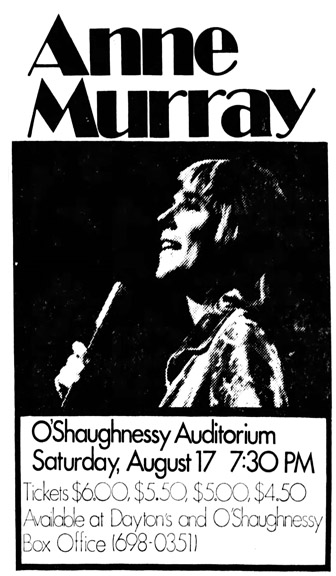
Minneapolis Tribune, July 28, 1974
ELLA FITZGERALD
Ella Fitzgerald, September 13, 1974, 8pm. One sold-out show.
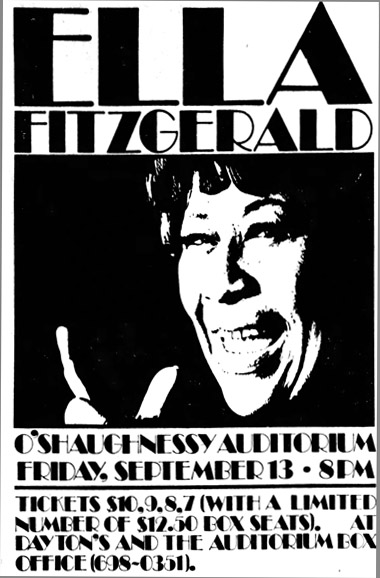
Minneapolis Tribune, September 8, 1974
This concert was reviewed by Roy M. Close (Minneapolis Star, September 14, 1974) and Jim Fuller (Minneapolis Tribune, September 16, 1974). Both thought the concert was superlative, and had nothing but good things to say about the voice and presentation of Miss Fitzgerald.
Fuller noted the she had:
lost only a touch of her original richness of voice and none of her remarkable range. Her control as she slides, leaps, and warbles up and down the scale still is astonishing when Miss Fitzgerald sings it.
She was backed by the Tommy Flanagan Trio, which also provided the opening session. The Trio included veteran trumpeter Roy Eldridge, who, in Fuller’s opinion, was a little on the old side to be as good as he once was.
The Trio provided at a set that was over 20 minutes after 8:00, and it was after 9:00 before Miss F’s set began, but she gave the audience 75 minutes of music, after two solid hours, everyone went home happy.
Songs included:
- Sweet Georgia Brown
- Good Morning, Heartache
- The Way We Were
- Miss Otis Regrets
- The Boy From Ipanema
- Donkey Serenade
- Temptation
- Fly Me to the Moon
KRIS KRISTOFFERSON AND RITA COOLIDGE
Kris Kristofferson and Rita Coolidge, September 29, 1974, 7 & 10. Music Sphere Productions. No review found.
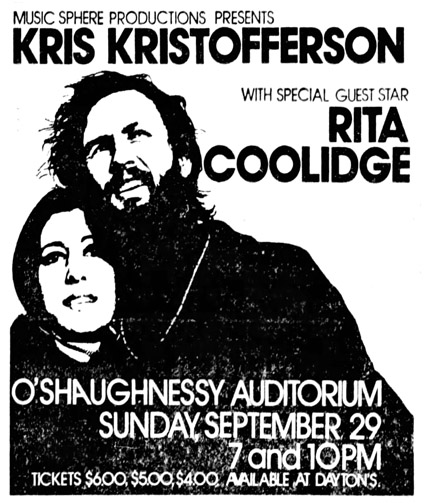
Minneapolis Tribune, September 22, 1974
KEITH JARRETT
Keith Jarrett, jazz pianist, performed at the O’Shaughnessy with the St. Paul Chamber Orchestra on December 21, 1974. 8 pm.
Jarrett was in town to perform four concerts in the Twin Cities: (Minneapolis Star, December 16, 1974)
On December 17, 1974, he performed his own works at the Janet Wallace Fine Arts Center at Macalester College with the St. Paul Chamber Orchestra.
On December 18, 1974, he performed at the Walker Art Center. This concert was also with the St. Paul Chamber Orchestra and included works by Hayden and John Cage.
On December 21, 1974, Jarrett’s third concert with the St. Paul Chamber Orchestra took place at the O’Shaughnessy.
The show opened with Felice Magendanz’s performance of Haydn’s Cello Concerto in C Major. Next, soprano Barbara Nelson and alto Michaela Mahady sang the Bach cantata “Gelobet seist Du, Jesus Christ.” Reviewer Roy M. Close wrote that these performances rendered the program a “remarkably miscellaneous affair” with “something for everybody.”
Jarrett played two works. First was his his own composition, “In the Cave of the Light,” scored for piano, strings, gong, and percussion, running 14 minutes. Close reported that it “struck me as a pleasant but not memorable display of instrumental pastels – sort of jazzified Ravel.”
The second piece he played was Carla Bley’s “3/4,” which Close found rather more interesting – “a 20- minute piece of considerable variety and force.”
In general, Close found the 29-year-old Jarrett to be “prodigiously talented.” “In both pieces he strove for romanticism and richness of expression. He “handled his part masterfully,” as did the orchestra, under the baton of Dennis Russell Davies.
The fourth and last concert in the series took place on December 22, 1974, when Jarrett’s jazz group performed at the Guthrie. See the page on the Guthrie for a review of this show.
Thank you to Jeff Neuberger for information about this venue.
The Oak Grove Country Club opened on May 11, 1929. It was located in Fridley, three miles up Central Avenue from the Minneapolis city limits at 37th Avenue NE, approximately at Moore Lake. (Turn left at the little white store…)
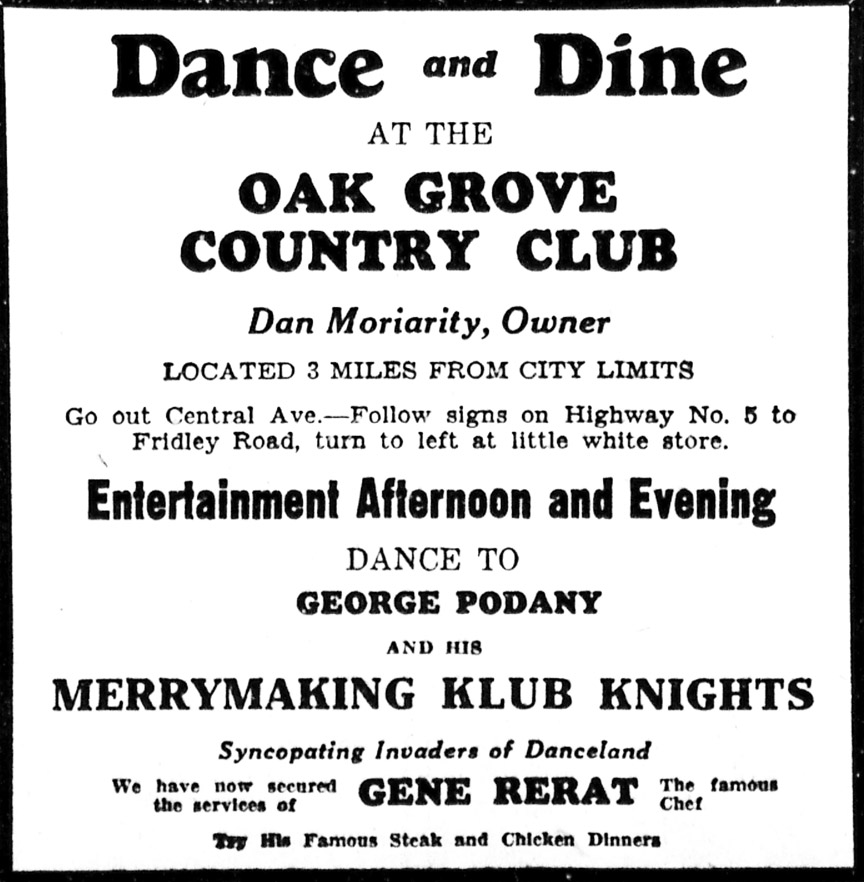
May 29, 1929
Its owner was “Handsome Dan” Moriarty, a Minneapolis restaurant and saloon owner and former resort owner (euphemism for bordello). It was a two-story building on a five-acre site, with the first floor having dining and dancing, and the second floor measuring 20 x 60 feet given over to roulette, craps, blackjack, and poker.
Some of the bands who played there were the George Podany Orchestra, Mildred Couch and her Rosebuds, and the Harold Betts Orchestra. Harold Betts broadcast on WRHM radio from the Oak Grove in 1930. WRHM would later become WTCN radio.
WHERE DAN WENT, TROUBLE FOLLOWED
On October 5, 1929, Feds paid a visit to the Oak Grove. While they made no arrests, they noted evidence of drinking and requested the presence of Handsome Dan to answer some questions.
On July 5, 1930, head bouncer Martin Tobin got into an altercation with two men leaving the Oak Grove. Tobin slugged one of the men, and from the ground the man fired a pistol and shot Tobin twice in the abdomen. The two men left at a high rate of speed. Tobin was taken to Eitel Hospital (across from Loring Park). While there he was asked by Anoka County Deputies who shot him. True to the gangster code, Tobin replied “I ain”t squawking.” Martin Tobin died on July 7, 1930.
The man who shot Tobin was believed to be New York gangster Mike Ritter. His companion was William Stone, a North Minneapolis gangster. Stone’s body was found in a shallow grave outside Owatonna, Minnesota, in September 1930.
On September 12, 1930, Gertrude Mantle made the news when she and her girlfriend accepted a ride home from the Oak Grove from the McMann Brothers, one of which turned out to be “a self-styled tough gangster from Cicero.” The man decided to take them for a ride – the friend got away, but Gertrude went for the ride until she jumped from the speeding car.
On September 21, 1930, the club was raided by the Anoka County Sheriff and gambling devices were found. The papers made much of Moriarty’s man-about-town image and his indifference to the eight charges heard by the “gray-haired woman judge.” An editorial also made fun of the cops and the Feds, chiding them for not realizing that the club had been offering liquor and gambling for over a year and a half.
On December 24, 1931, the club was hit with a temporary injunction and closed for creating a nuisance.
On February 9, 1932, the club was allowed to open, but the district court judge ordered an injunction against gambling, dancing, and liquor at the club.
Dan Moriarty died on April 7, 1932, at the age of 47 from pneumonia.
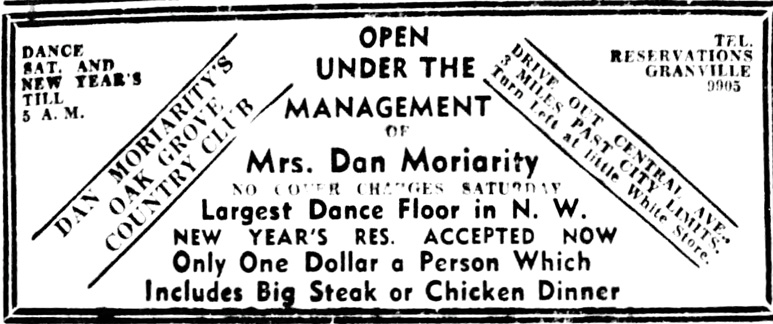
December 23, 1933
After Moriary’s death the club changed hands and names a few times. It was advertised for sale in August 1934 and again in April 1935.
The Oak Grove Country Club had a Swiss-born chef named Eugene A. Rerat. He was an criminal attorney who defended several gangsters in Minnesota. He married Violet Peifer, the widow of Saint Paul gangster Jack Peifer. In the 1940s, Rerat switched from a criminal law to a highly lucrative personal injury practice. The Rerats had a home in Fort Lauderdale, Florida, and a 5 bedroom, 4 bathroom home in Golden Valley modeled after a French Chateau they saw outside Paris.
The Rerats had a son, also named Eugene. The family would travel to Europe, Brazil, and the Bahamas. Like his father, Eugene Rerat enjoyed cooking and was a member of an Amateur Chef society. Eugene Sr. died in 1979 and Violet Rerat died in January 1984 in Fort Lauderdale.
230 Oak Grove Street. This hotel was (and is) by Loring Park in Minneapolis – now apartments. It was built in 1920, and was one of the most posh hotels in town, hosting the likes of Elizabeth Taylor and Jackie Gleason when they were in town. In 1923 it was the home of radio station WLAG, which became WCCO. Presumably it had a house and/or radio orchestra.
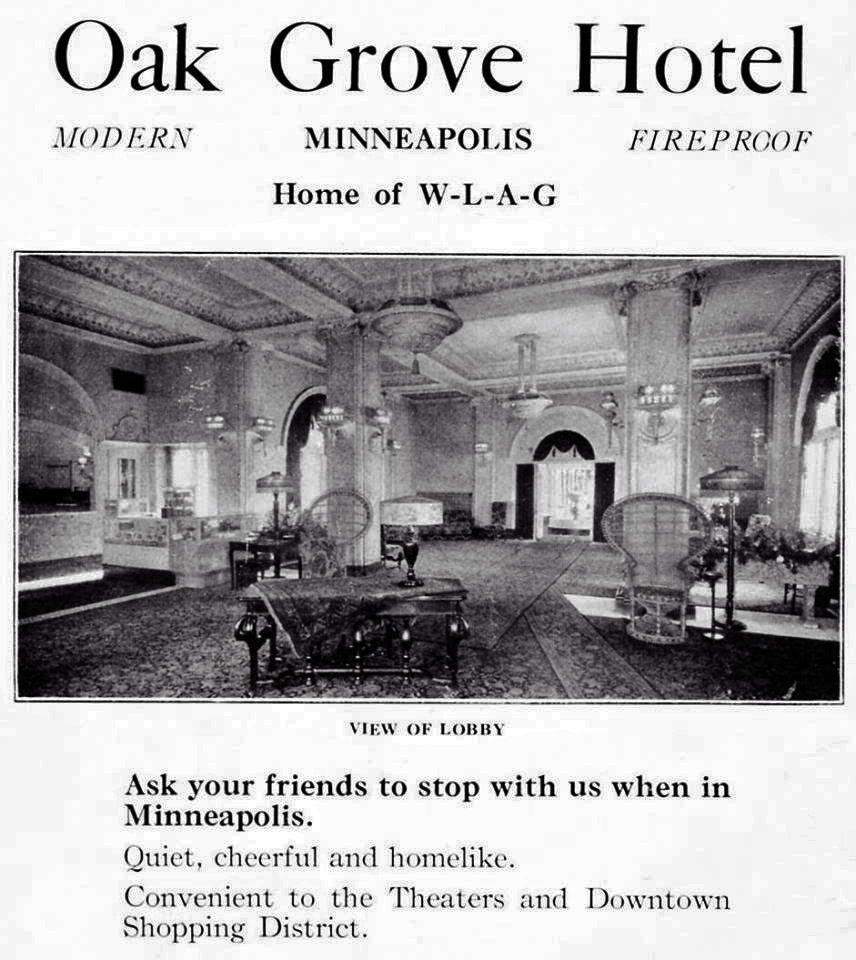
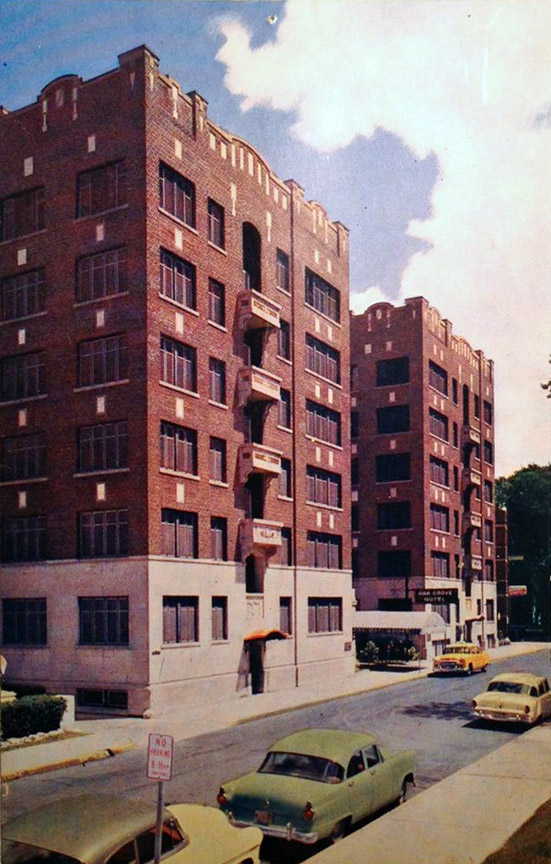
Alan Freed found this postcard of the Oak Grove Hotel from the 1950s.
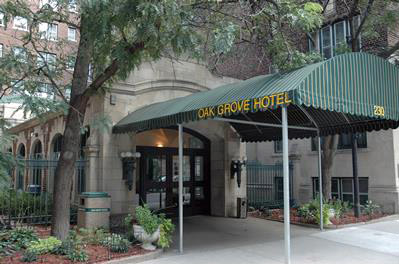
The Oak Grove in recent times
Superior Blvd. (I-394), Hopkins. This was the site of local dances in 1928. Exact location unknown.
The Oak Ridge Resort was on Crooked Lake in Anoka. Percy Hughes played there in 1952.
Obbs Bar was located at 1347 Burns Ave. in St. Paul.
In April 1962 its owners were Glenn and Robert Johnson.
Last match in a Strib search is in 2014, where it’s called Obb’s Sports Bar and Grill.
This downtown Minneapolis lounge was located at 217 South Sixth Street.
The building was built in 1899 as a store. In the 1920s it was the home of Real Estate Company, but in 1923 it was raided as a speakeasy. In 1936 it was called the 217 Cafe; the next year it was Geyer’s Cafe. There was a fire in 1937, and in 1946 it became the Business and Municipal branch of the Minneapolis Public Library.
Music venues included:
- The Office, and
- The Red Baron
THE OFFICE
The Office opened in August 1962. The owners were George E. Schaumberg and George P. Flynn, and Thomas E. Dougherty. The manager was George L. Pappas. (Don Morrison, August 28, 1962) Pappas was the former owner of Club 26, at 2626 Hennepin Ave.
The liquor license was that of the old Sourdough Bar, one of the Skid Row establishments demolished in the name of urban development.
In the summer of 1963 the basement was opened as the Conference Room, operated by John Anzevino and Frank Yarnusso.
It featured Gary Nielsen and the Night-Caps in 1965. It was a 21 or older venue.
It was plagued another fire in March 1965, according to the permit card.
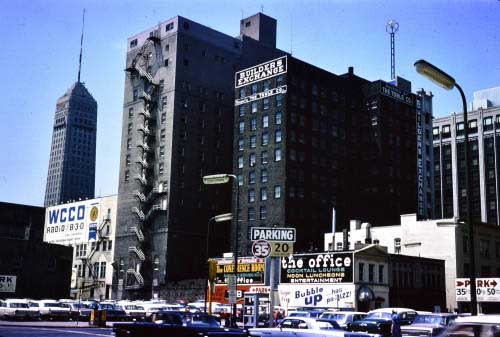
The Office can be seen in this photo from the Hennepin County Library Collection.
In September 1965 Schaumberg sold his holdings to John Anzevino. Schaumberg was to continue as Vice President and Secretary, but he went to St. Paul to run the Red Carpet.
Here’s a glimpse of it from an episode of Route 66 shot in Minneapolis, courtesy Alan Freed.
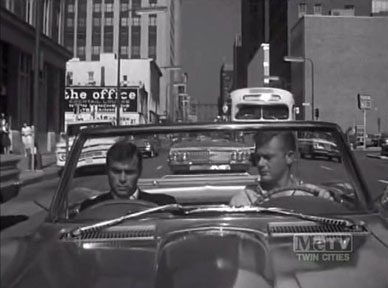
THE RED BARON
The Office became the Red Baron, and the details were reported by Will Jones in his column of August 18, 1966.
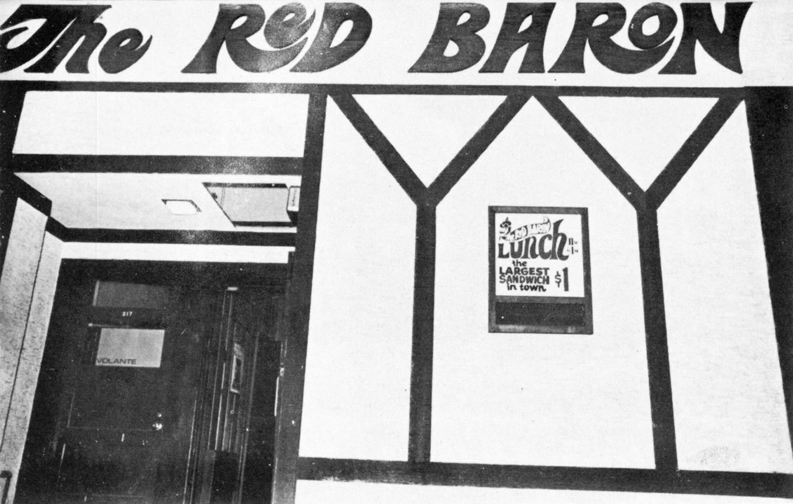
Insider photo, May 1969. Copyright Mike Barich, St. Paul
It had a World War I theme, inspired by Snoopy cartoons. The basement bar was called the Bomb Shelter. The owners were Tom Gray, Ted Doman, and Ronnie Berglund. Two of them had worked at the Vincent Van Go-Go next door, and planned to run it the same way.
In March 1969, the Red Baron was the site of a test case when 28-year-old cocktail waitress and college student Judy Jarosek became a bartender, in opposition to a city ordinance that prohibited women from tending bar where hard liquor was sold. She was not arrested on her first (and only) day as a bartendress, as she chose to be called, to her disappointment. Instead, the owners of the bar were called for a hearing, where they agreed not to challenge the law again.
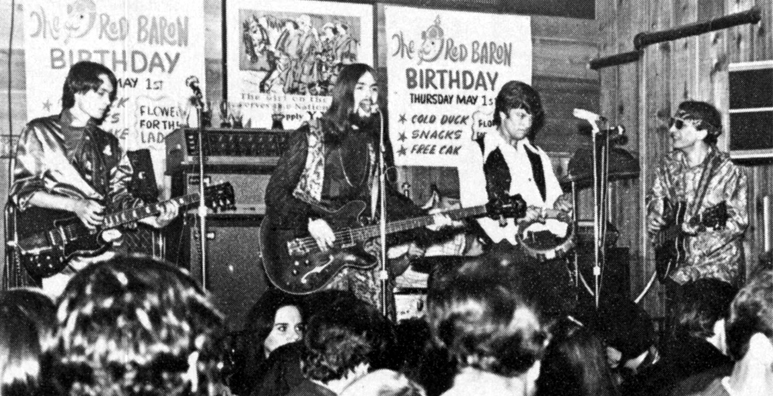
Zarathustra at the Red Baron. Photo from the Insider, April 1970, Copyright Mike Barich, St. Paul
The building had still another fire in October 1969 and the Paisleys lost all of their equipment.
This one was the last; the building was demolished in November 1970.
Save
Please see the Gay ’90s, Downtown Minneapolis.
The Old Southern Barbeque was apparently at two locations: 610 Lyndale (1937), and 700 No. Lyndale, which might have just been right next to each other.
It was a jazz venue run by “Ma and Pa Pettiford,” and members of the multi-talented Pettiford family made up the house band. It endured longer than any of the clubs in the Olson Highway district. It had been a storefront church, a restaurant since 1939, and was named the Old Southern Barbeque in 1949 or ’50. In 1943 there was a memorable jam session one Saturday night with members of Cab Calloway’s, Duke Ellington’s, and Woody Herman’s bands. “The session lasted until 8:00 the next morning, when the police broke it up.”
In February 1963 an article cited Cicero Flood as the owner and reported that the City was trying to crack down on prostitution at the club. By 1964 it still existed as a restaurant but no longer offered live music or after-hours sessions.
mentioned in a Will Jones column in May 1963; apparently packed on Sunday nights with mostly a listening crowd.
Much of the following information comes from a Ph.D. thesis presented in May 1964 by U of M graduate student Robert A. Stebbins entitled The Jazz Community: The Sociology of a Musical Sub-Culture.
Also see:
A History Of North Minneapolis: Sumner Field
SIXTH AVE. NO.
Sixth Ave. No. was a commercial street in one of two predominantly black areas of Minneapolis. The site had once been the Oak Lake Addition, the finest section of the city in the 1890s. Most of the buildings on the 700 block (at Lyndale) were built in the 1880s and ’90s. They were most likely either built as houses and became apartments and stores or were built as apartments and stores to begin with.
By 1900 Jewish immigrants began to settle in the area and the wealthy residents began to leave.
The start of World War I saw a migration of blacks to Minneapolis, and by 1920 Oak Lake was almost entirely black. The old established white families had moved farther south along Lyndale Avenue and the Jewish community had moved farther west along 6th Avenue No. and Plymouth Avenue. A commercial strip developed along 6th Ave. with stores, offices, machine shops, etc.
Clarence William Miller reminisced about the heyday of the Avenue in the 1920s. He described two men’s “social clubs:”
- The Four Leaf Clover Club was made up of men who “made their income from the earnings of their women.” They gave Holiday Breakfast Balls, at the Southside Auditorium, which lasted from midnight to 5:00 am. Eli Rice’s orchestra played for all of these affairs.
- The Wolverine Club, of which Mr. Miller was the sole survivor as he wrote his memoirs, hosted dances in the hall over the Nankin Restaurant.
Also in the 1920s it was said that Kid Cann had a headquarters on the south side of Sixth Ave. between Colfax and Dupont.
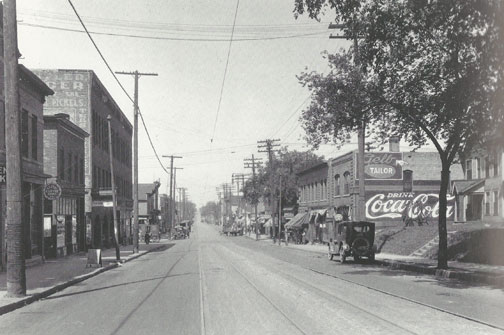
Photo from the old days courtesy Minneapolis Collection, Hennepin County Library
OLSON MEMORIAL HIGHWAY
In 1933 construction was authorized for Highway 55. Upon Governor Floyd B. Olson’s death in June 1936, the Minneapolis City Council renamed the stretch of road between Lyndale Ave. and the City Limits Olson Memorial Highway on September 10, 1937.
The following is an article in the Minneapolis Spokesman dated September 10, 1937:
Sixth Avenue North, that picturesque section of Minneapolis which has ranked in the minds of the well traveled as does Beale Street in Memphis, State Street in Chicago, Market Street in St. Louis and Lennox Avenue in New York, will soon lose its former identity if plans announced by a Minneapolis city council committee are carried out.
Friday the city council is expected to pass a law renaming the famous thoroughfare Floyd Olson Memorial Highway. That portion of the street from Seventh Street to the west city limits will be affected.
The most famous corner on Sixth Avenue North is the Lyndale Avenue corner where for years the colored people of that section have congregated making a street which was highly reminiscent of parts further south.
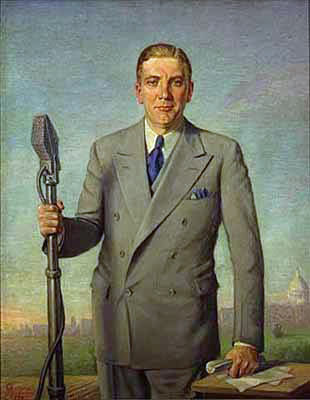
Statue of Floyd B. Olson, situated on south side of Highway 55.
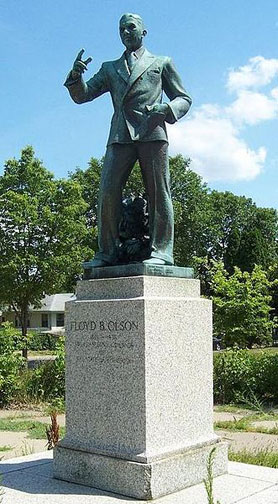
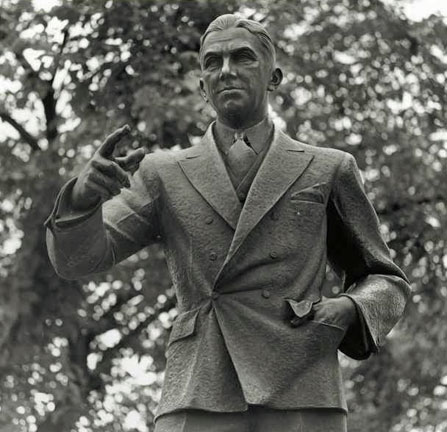
Black and white photo courtesy Will Lumpkins
By 1937 the area had become a slum, and one of only two places in the city where blacks were allowed to live. Even after restrictive covenants were struck down by the Supreme Court in 1948, de facto segregation existed for decades, forcing blacks of all classes to live in substandard housing. Oak Lake itself was filled in to provide room for the municipal market, completed in 1937.
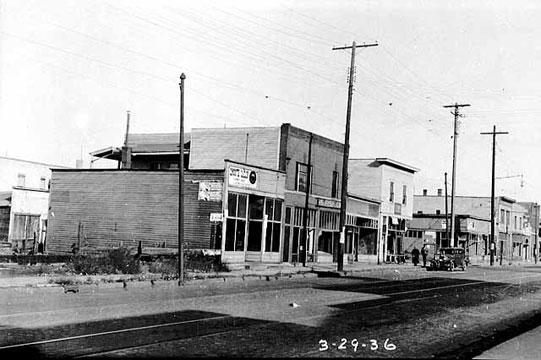
Minnesota Historical Society
SUMNER FIELD
Buildings on the north/even side of Olson Memorial Highway were demolished in 1936 in order to build the Sumner Field Public Housing Project, the first such project in Minnesota. It consisted of 44 two-story row houses and four three-story apartment buildings in municipal park-like setting. It was a government effort to clear slums, address a housing shortage and create construction jobs during the Great Depression. Private landlords opposed it.
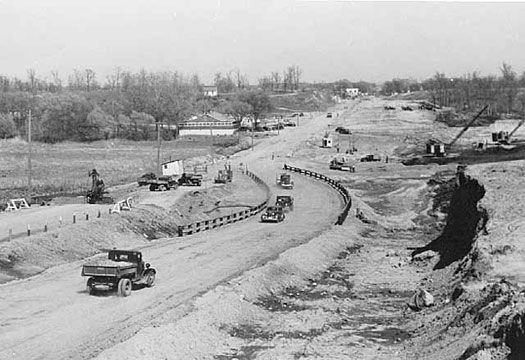
1940
The early residents of Sumner Field were predominately Jewish along with some African-Americans. It was originally racially segregated, and eventually became predominately African-American. In the 1970s it became home for a large population of Southeast Asian refugees. Sumner’s most famous residents were the musician Prince Rodger Nelson and Richard Green, who at one time led the Minneapolis and New York school systems.
Sumner Field was the oldest, largest and second of four housing complexes demolished under the settlement of a lawsuit (1995 Hollman settlement) alleging that public agencies discriminated by concentrating minorities in inner-city public housing. Sumner Field was razed in 1998. It was replaced by the Heritage Park Housing Development, built between 2002-2009. Heritage Park is roughly bounded by Lyndale, Emerson, Third and 10th Avenues North. It is a mixed income development that no longer concentrates minorities or the poor.
GLENWOOD REDEVELOPMENT
The remaining buildings on the south side continued to deteriorate;
Stebbins:
With the deterioration came vice and crime, with prostitution, gambling, and after-hours drinking commonplace. But it also provided the fertile ground from which Minneapolis’ most fully developed jazz community sprang.
In 1955 the Glenwood Redevelopment Project was undertaken by the City of Minneapolis, razing nearly all the buildings from the Harrison School to 7th Street No. and from Olson Memorial Highway to Glenwood Ave. With the demolition went the Oak Lake Addition and the numerous little bars, restaurants, after-hours joints, and the Olson Highway jazz community.
Stebbins mourned the loss of the old neighborhood:
… giant wrecking machines were battering into rubble many of the buildings from which the alternately gay and mournful strains of jam sessions had once filtered through decaying walls to drop like sleet into alleys, where once denizens of this midnight world had slouched half drunk and stolen a furtive look both ways before relieving themselves, half concealed, behind the ash cans. The bulldozers were sweeping the rubble rattle-trap rooming houses, dives and bistros, into piles which would later be loaded into dump trucks and hauled away.
Below: Architect Oskar Stonorov (left) and University of Minnesota architect professor Walter Vivrett look over a plan of the Glenwood redevelopment project of the area in 1957.
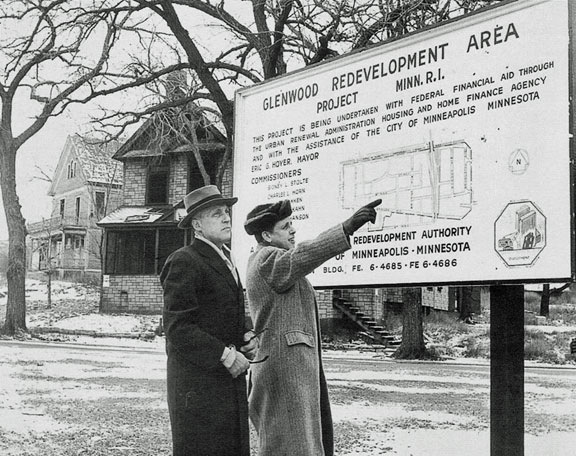
StarTribune photo.
Here is a Spreadsheet I started, taking info from the Minneapolis Spokesman and inspection permit cards at the Minneapolis Downtown Library’s Special Collections. Special Collections also has reverse directories, which I have not looked at… yet. This spreadsheet badly needs updating. The most interesting building has to be 718 Sixth Ave. No., which hosted such venues as the Cotton Club, Club Kongo and Club Morocco. It was the last building to fall.
Save
Save
One Groveland was at 19th and Nicollet under the Plymouth Church Tower. In November 1970 an ad indicated concerts by Cottonwood, the Paisleys, Thundertree, and others, but with no firm dates. The ad also said that brown rice was served and that it was open weekends and days.
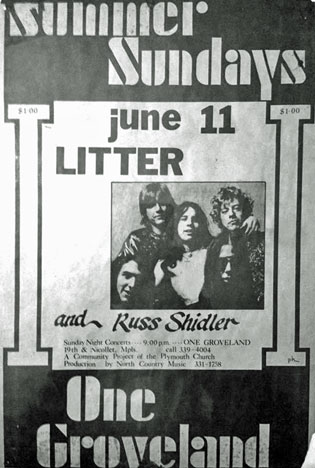
This poster was posted on Facebook by Paul Pash, and according to the day and date must be from 1972.
See the Bull Pen.
This building was located at 210 Washington Ave. So. It was built in 1889.
ORCHESTRATION HALL opened its door in 1889.
JUMBO THEATER: 1890 – 1894. This was apparently a den of sin, as the police went about looking for “boys” in the audience, and a tourist somehow lost $50 while looking around backstage
CENTRAL GARDEN: On May 3, 1984,its interior was demolished in a fire that started in the adjoining Reed Building.
NEW JUMBO: 1894 – 1896
COLUMBIA THEATRE: 1896
EMPIRE THEATER: 1903
Randolph Edgar reported that this was the first place in Minneapolis where motion pictures were shown. These 20 minute shorts were shown at the end of the regular performance, and were brought over from the Orpheum Music Hall in St. Paul where they had been shown earlier in the evening
1500 Fourth Ave. So. In 1937, the Northwest’s Finest Night Club – dine and dance.
There were two Orpheum Theaters.
25 So. 7th STREET
Bryan Krefft at CinemaTreasures.org:
Minneapolis’ first Orpheum Theatre opened October 22, 1904, an elegant and luxurious Beaux-Arts building built for the Orpheum vaudeville circuit.
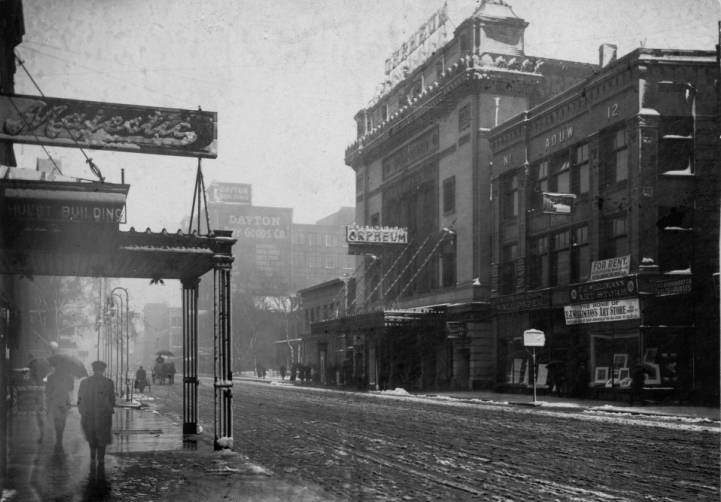
The Hennepin County Library dates this photo as 1900, which contradicts the 1904 date.
Seating around 1,490, the Orpheum Theatre’s impressive facade of limestone and terra cotta featured the circuit’s name boldly inscribed above the two-story colonnade above the main entrance, which was covered by a simple glass-and-iron canopy marquee. In the early years, the only signage on the first Orpheum Theatre was the theater’s name in large letters on the rooftop, illuminated by lightbulbs at night.
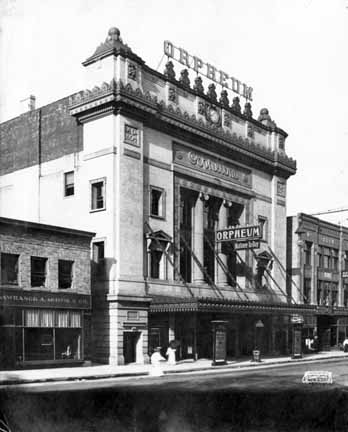
First Orpheum 1905. Photo Minn. Historical Society
Among the many big-name performers in the Orpheum Theatre’s vaudeville days was Houdini, in his first Minneapolis appearance, in 1915.
7th STREET THEATER
When the Orpheum circuit built the much larger and more ornate Hennepin Theatre in 1921, they made that theatre their new Minneapolis home a year later, renaming it the Orpheum Theatre. The first Orpheum Theatre reopened August 27, 1922 as the 7th Street Theatre. [It appears that the program was a mix of movies and vaudeville until at least 1927.]
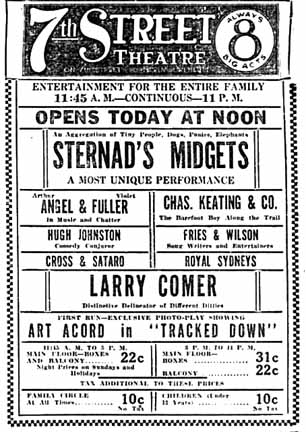
Minnesota Daily Star, August 30, 1922. CinemaTreasures.org
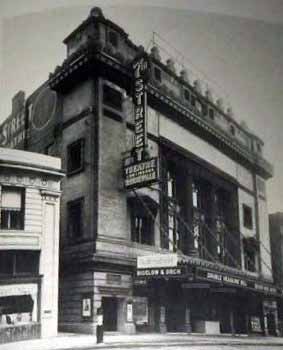
Courtesy CinemaTreasures.org
The 7th Street Theatre closed in 1940, and was torn down soon after, a sad ending for a still-beautiful and usable theater.
910 HENNEPIN AVE.
The second Orpheum Theater, which exists today, is located at 910 Hennepin Ave. It was constructed in 1921 at a cost of $1,250,000, and was originally called the New Hennepin Avenue Theater. Contemporary news accounts put the number of seats at 2,928; the current number is listed as 2,579. The theater opened on October 16, 1921.
Indented material below is from the website of the Hennepin Theater Trust, the owner of the Orpheum:
The Orpheum Theatre was designed by the Milwaukee firm of Kirchoff and Rose in a Beaux Arts style. Its first performers included the Marx Brothers, with more than 70,000 guests attending the opening week run. Billed as the largest vaudeville house in the country when opened, it became a major outlet for such entertainers as Jack Benny, George Burns and Fanny Brice. The Orpheum featured a playroom and day care off the mezzanine lobby and backstage had eight floors of dressing rooms.
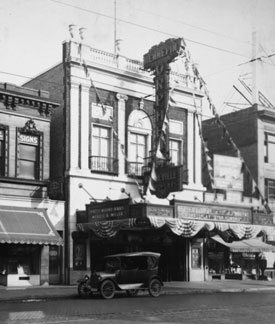
External photo, 1925: Minnesota Historical Society
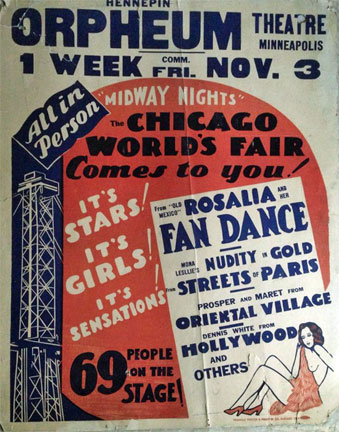
As vaudeville declined in the 1930s and ’40s, the Orpheum became one of Minneapolis’s major cinema houses, with “Gone with the Wind” in 1940 selling out every show for three weeks. It also hosted big bands including Benny Goodman, Tommy Dorsey and Count Basie.
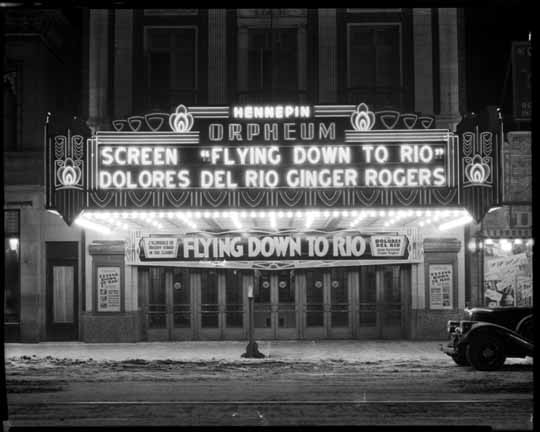
Orpheum Theater, 1933. Photo Minnesota Historical Society
In 1959, Ted Mann, owner of six other downtown Minneapolis theatres, including the Pantages, bought the Orpheum and brought in touring productions including “My Fair Lady” and “Fiddler on the Roof.” Movies also continued to be shown, with the 1965 James Bond film “Thunderball” shattering box office records. The Orpheum set a Minneapolis record for first run engagements of Best Picture Oscar winners – nine in all – including “From Here to Eternity” in 1953 and “The Godfather” in 1972.
Bob Dylan and his brother David Zimmerman bought the theater in 1984 and Zimmerman refurbished it in “warm, living-room colors.” Broadway touring companies balked at coming to the theater because of its poor condition, lack of air-conditioning, and the deteriorating Hennepin Ave. The building is closed in 1988.
In 1988 the Minneapolis Community Development Agency purchased the Orpheum from Dylan and Zimmerman. Restoration began in 1993 and, to accommodate elaborate Broadway productions, the Orpheum stage was extended almost 20 feet, with the back wall of the theatre painstakingly removed brick by brick. Unexpected architectural discoveries made during the renovation of the lobby included six terra cotta bas relief Pompeiian friezes previously hidden under velour curtains, fake window grids and a false wall. The chandelier in the main auditorium is the theatre centerpiece. It is 15 feet high and weighs 2,000 pounds.
The theater actually consists of two separate structures: a long, fingerlike lobby that extends back from a narrow facade along Hennepin Avenue, and the auditorium, which is set back and parallels Hawthorne Avenue. The auditorium is intricately plastered, with a number of garlands, swags, medallions, and other
decorations. The ceiling has a dome with 30,000 squares of aluminum leaf. The building seats 1500 on the main floor and 1100 on the three level balcony.
Following a $10 million restoration, the Orpheum re-opened in December 1993 with a concert by Heart, and in January 1994 with the Broadway production of “Miss Saigon.” Productions that have originated at the Orpheum include “Victor/Victoria,” the pre-Broadway world premiere of Disney’s “The Lion King,” and the national tour premiere of Elton John and Tim Rice’s “AIDA.”
From its reopening in 1993 until 1996 the theater was operated by the Ordway Music Theatre, and then by the Historic Theatre Group. Historic Theatre Group’s original partner was Jujamcyn Productions. SFX (now Live Nation) bought Jujamcyn Productions in 2000. Live Nation sold most of its theatrical properties, including its Minneapolis operations, to Key Brand Entertainment in 2008. In 2005 the city transferred ownership of its theaters to the Hennepin Theatre Trust. Hennepin Theatre Trust is now the owner and operator of this magnificent structure.
Kenneth Stuart remembers the Big Band era:
The format was to show a movie and then the band would come out for a 15 minute session and then back to the movie. This went on all day and was one hell of a treat to pay a quarter to get in and be treated to all this tremendous (a 1940s term) big-band music. Big bands that appeared were Horace Heidt and his Musical Knights with the Triple-tonguing Trumpeters; Artie Shaw with “Little Jazz;” Roy Eldridge, fresh out of the Army, wearing high-water trousers; Sammy Kaye and his “So You Want To Lead A Band?” show. I led the band and did well but lost out to a pretty, hip-swinging chick, in a white summer dress, in front of a room filled with sailors from the Wold-Chamberlain Naval Station. I got to keep the autographed baton as a souvenir, however, which I promptly lost the first move I made after that. The best show I saw back then was the Gene Krupa Orchestra. The huge drape curtains would close immediately after the movie in preparation for the entrance of the orchestra. First, there was a double-paradiddle and then their theme song “Starburst” started playing as the curtain opened and the band rose from below stage level, facing backwards and then turning to present itself to the audience. Everything was in slow motion except the theme song. I’ve seen big bands all over the place including in, at least, three countries and that first showing by the Gene Krupa big band was the greatest musical thrill of my life.
Save
Save
Save
Save
Save
See the Loeb Arcade Building.
Our Place was located at 54th Street and Florida Ave. No. in Crystal.
It was designed for junior high kids to hang out and dance in a non-school environment, and operated in a leased part of a building.
It opened in July 1968, and music was provided by a jukebox. The photo below isn’t very good, but it shows that there were also live bands that provided the music for dances.
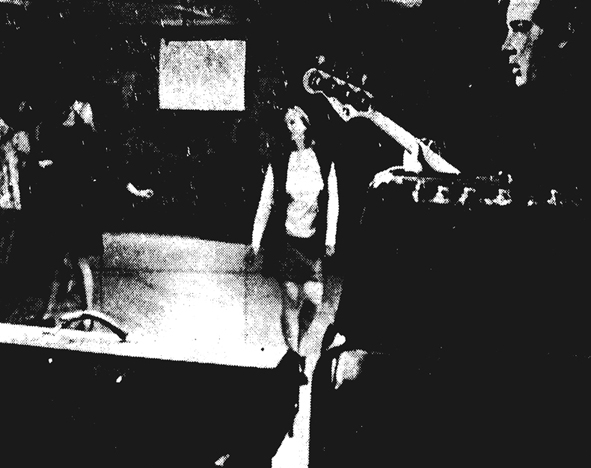
Minneapolis Tribune photo by Skip Heine, April 28, 1969
But complaints quickly arose about noise, smoking, and the usual things people complain about teenagers doing. The lease was not continued, and the last day of Our Place was April 26, 1969. The teens were incensed, and there were reports of a shoving match with police, and a proposed sit-in. But eventually everyone left at about 1 am, and Our Place was no more.
The Owasso Blvd. Tavern was located on North Owasso Blvd. and Rice Street in St. Paul. Thanks to Jeff Neuberger for his help!
It opened October 28, 1931 for the football crowd
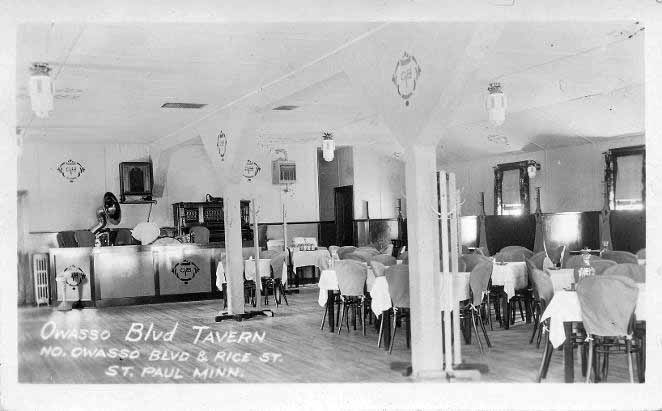
in St. Paul in 1934, and featured a band, as evidenced by this photo from the Minnesota Historical Society. Bob Patrin says that it was busted for serving liquor after hours.
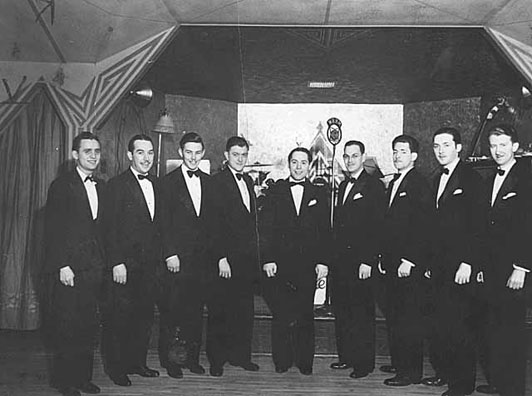
Owasso Boulevard tavern located at Rice street and Owasso Boulevard had live music (as the ad says) gambling, and then illegal Alcohol. Harry Sawyer, owner of the Green Lantern, owned a piece of the Tavern and payoffs were made to the Ramsey County Sheriff to keep it in operation.
On Sunday, November 24, 1935, the Owasso Boulevard Tavern burned down in a fire. The loss amounted to $10,000.
Save
Selby Ave., St. Paul – jazz venue
Please see Lowry Hotel.
During Prohibition there were lots of so-called “chicken shacks,” which were often fronts for speakeasies. These photos from the Minnesota Historical Society show some folks in Minneapolis who worked at such an establishment in 1930. How could they not have had music? The notation in MHS’s files say that this was the P & S Chicken Shack, located at 629 Sixth Ave. No., a hotspot of action. The P & S goes back to at least 1919, and was marketed as Mammy’s Fried Chicken for a while.
The building at 629 Sixth Ave. No. was demolished in 1946. It may be that the company operated out of the Kistler Building from 1931 to 1933, and even put on shows, as the ad below indicates. It’s a mystery!
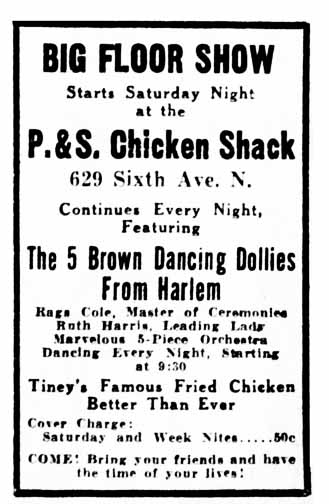
Minneapolis Tribune, February 5, 1931

Minneapolis Tribune, October 14, 1933
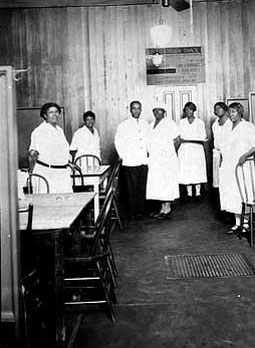
Photo courtesy Minneapolis Historical Society
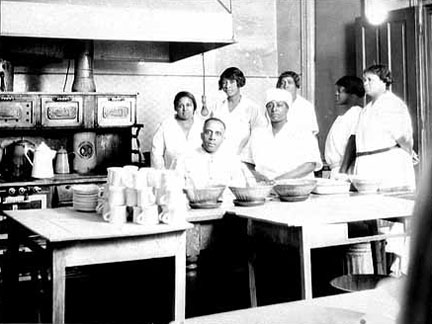
Photo courtesy Minneapolis Historical Society
Save
Save
The Padded Cell was located at 925 W. Lake Street at Colfax Ave. in Minneapolis.
HAROLD’S CLUB
The bar had been known as Harold’s Club, but as George Grim explained in his column of December 24, 1955, there was a well-known Harold’s Club in Reno, so the locals had a contest to give the place a new name. Thus came the name the Padded Cell.
PAUL FINK
It was owned by Paul Fink, a former San Francisco policeman. Fink kept two monkeys in the place, which was probably amusing but not too sanitary… Mel remembered that Fink was a Big Tough Guy (Will Jones said he weighed 350) and one night he mixed it up with the local gendarmes and it took six of them to take him down.
JAZZ
In 1957 it featured a Dixieland band and that summer it even had a float in the Aquatennial parade. In 1958 Erik Storlie described it as a “tough workingman’s bar.”
The format then switched to modern jazz, featuring local and out of town groups, including Kai Winding’s Sextet, Pat Moran’s group, the Marion McPartland Trio, Jack Teagarden, Peter Nero, and Charlie Ventura. Next door was a Charburger where musicians from all over town would congregate when their jobs were over. There was apparently a song going ’round called “Paul Fink’s Padded Cell.”
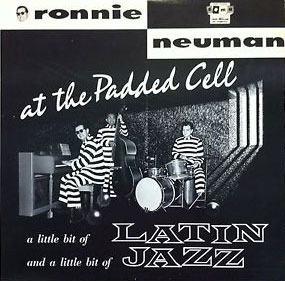
If you’ve got $250 you can buy this SOMA LP on ebay!
FOLK MUSIC
Paul Fink left in 1964 and the format turned to folk music. The club hosted such major acts as Peter, Paul, and Mary – “For a couple of dollars and a pitcher of beer we saw loads of talent!”
The folk trio the Journeymen recorded their “Coming Attractions-Live!” album at the Cell in 1962. The cover described it as an “on-the-spot recording of an actual performance in Minneapolis’s famed Padded Cell.”
An article about folk venues in Life Magazine’s December 14, 1962 issue noted that the Padded Cell served “near beer.” The January 1963 Select Twin Citian shows that it was open 7 days/week, with 50 cents admission on weeknights and $1 on Friday-Sunday. Groups performing that month were the Contemporary Folk Group; Tom Pasle and Lynn Gold; and the Swagmen, “novelty folk quartet.” February groups included the Bandsmen and the Chessmen. In May 1963 there was a note that owner Fred Cole promised to get the place “back in gear this summer,” offering jazz, comedy, dancing girls, calypso, and folk, particularly the Contemporary Folk Group. In 1964 the club featured Epic Recording Artists Jerry Goodge and the Gold Briars and the Berkely Squires.
The site became the home of Mohn Electric for many years.
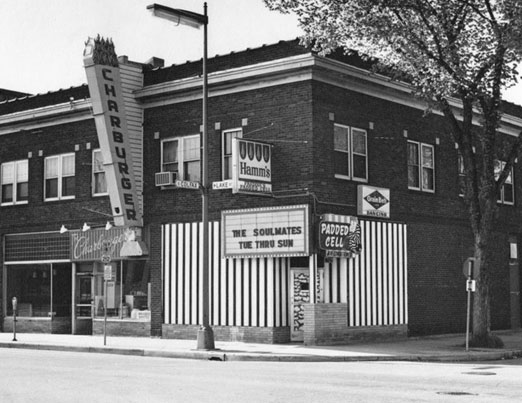
This Paddock Bar was located at 5540 N. Lakeland (Highway 52 near Bass Lake Road) in Crystal, and was owned by Earl C. Paddock. Earl also owned Paddock’s 305 Bar on West Broadway in 1961.
The Paddock opened in 1953, according to the ad below. Ads are difficult to find – maybe because the name was spelled vertically?
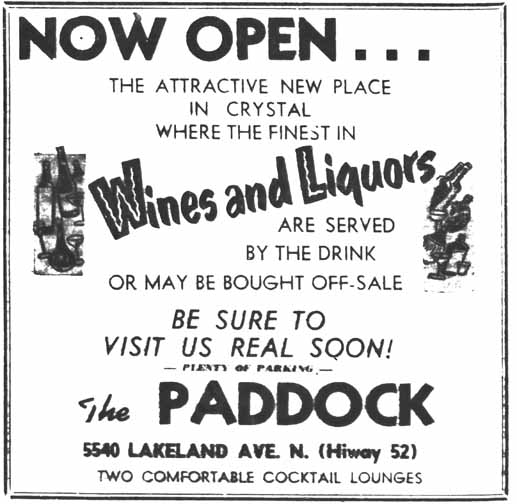
North Hennepin Post, December 31, 1953
Below is an absolutely fabulous photograph from the Robbinsdale Facebook page.
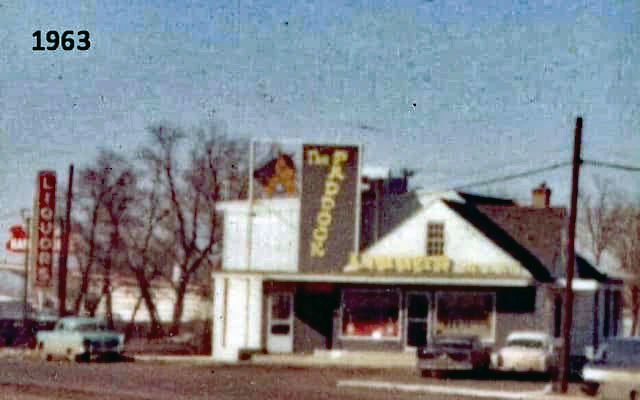
Image courtesy Nathanial Ryan Schaefer
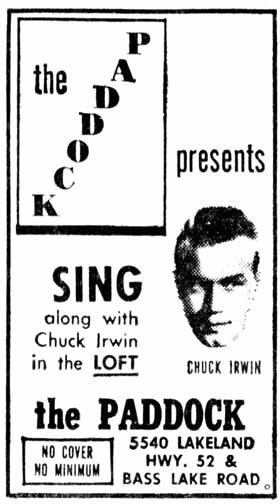
January 23, 1964
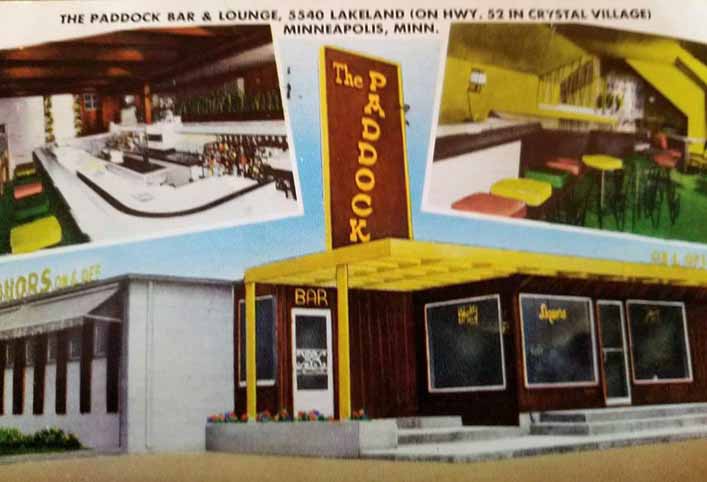
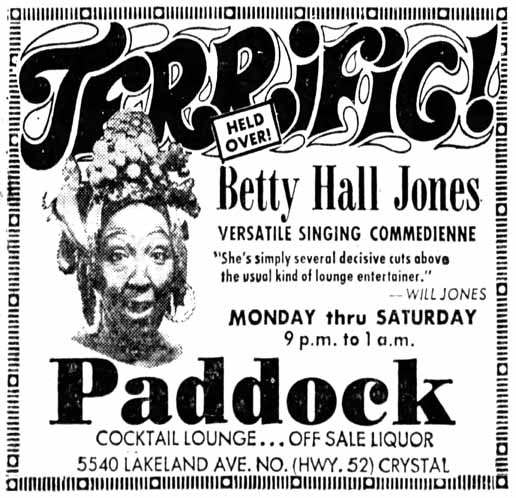
July 19, 1970
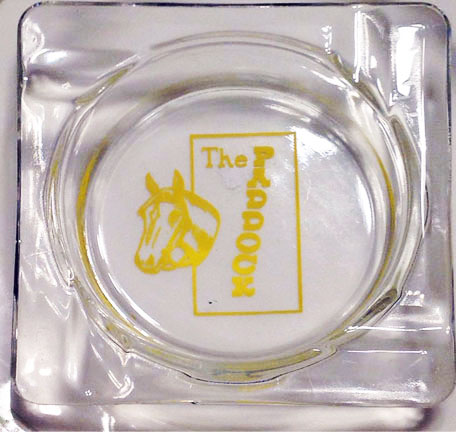
From the collection of Mark Youngblood
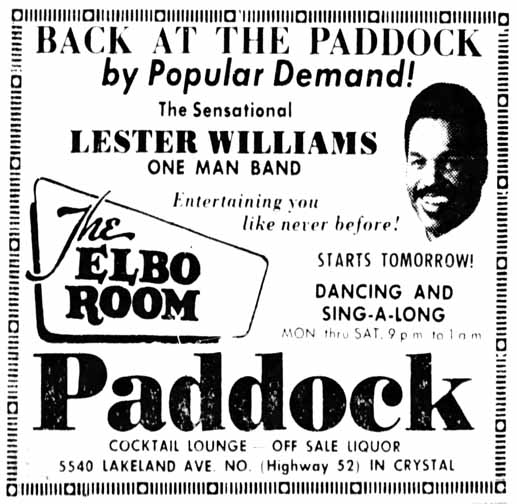
November 1, 1970
Tragedy struck the Paddock in March 1976 when a fight broke out in the parking lot and a 26-year-old stabbed a 19-year-old to death. He pleaded guilty to first degree manslaughter and was sentenced to 10 years in prison (stayed) and 10 years probation. He ended up having to serve one year in the workhouse.
The Paddock operated until at least 1985.
305 W. Broadway, Minneapolis.
In 1961 it was owned by Earl C. Paddock, who also owned the Paddock in Crystal.
Music? Dunno, but here’s a great ashtray.
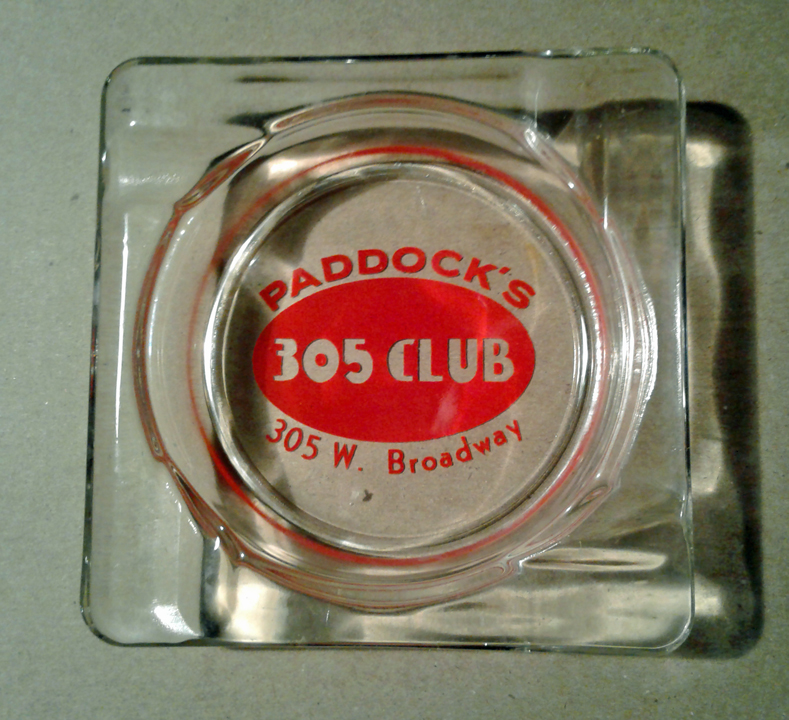
Courtesy Gary Tverberg
830 Hennepin. New in October 1955, with Dewey Harris at the piano. In 1967 it was advertised in the Local 1145 Honeywell News as Pal’s Variety Bar and Pal’s Country Kitchen, owned by Sterling Robson.
The Palace Inn, a/k/a Brisky’s Palace Inn, was located at 5607 West Broadway in Robbinsdale, from about 1950 to 1955.The proprietor was William J. Brisky.
The place offered on and off sale liquor and a restaurant – if it didn’t have music, it should have!
The image below was pulled from the Robbinsdale Facebook page.

Image courtesy Nathanial Ryan Schaefer
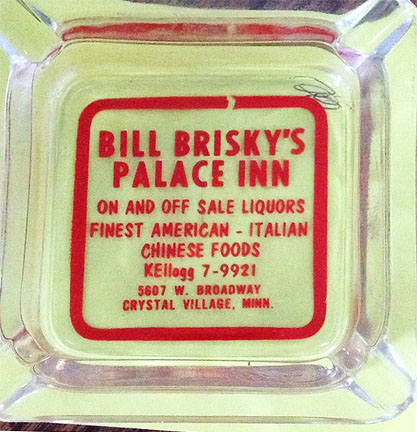
From the collection of Mark Youngblood
Despite its name, Randolph Edgar described this facility as having two fully equipped stages. Its full name was Kohl and Middleton’s Palace Museum, and it was located at 40-44 South Washington Ave at Marquette.
The Palace Theater was located at 414 Hennepin Ave.
The theater was built on the homestead of L.M. Stewart. See this page for much more interesting information on Stewart and his vast real estate holdings.
CONSTRUCTION
Excavation began on February 26, 1914, and it was front page news because Levi Stewart had been a longtime holdout, keeping his little cottage on prime Hennepin Ave. real estate. He died in 1910, and the land between 4th and 5th Street was finally ready for development. The theater was being built by the firm of Finkelstein & Ruben, which by 1914 operated at least six other theaters in the Twin Cities. It is interesting that in his review of opening night, Carlton W. Miles of the Minneapolis Journal gave Finkelstein & Ruben credit for having faith in the future of motion pictures to invest so much money into such a venture. Like so many things, there were people who thought that movies were a passing fad!
The Minneapolis Journal reported that on the first day of construction, 150 men and 50 teams of horses were on the job. S.J. Groves was doing the excavation, and the W.J. Hoy Company was the General Contractor. The architect was John Adolph Emil Eberson, with the assistance of the St. Paul firm of Buechner & Orth. (Larry Millett, Minneapolis Star Tribune, December 23, 2017)
The property was so well known that specific trees that were to fall were mentioned, almost by name. The excavators, doing the digging by horse and hand, were expected to reach the last cistern left in the business district – “a relic of the days when everybody collected rainwater for the Monday morning clothes washing.” (Minneapolis Journal, February 2, 1926)
The footprint of the building was 103′ x 157,’ as stated on the building permit, and although the permit estimated that the cost would be $150,000, the Tribune estimate that the cost upon completion would reach almost $600,000. Initial capacity was reported to be 2,400, but later reports mention 2,700 : 700 on the floor and the rest in three huge balconies.
SNEAK PEEK
The Minneapolis Tribune tells us that the new vaudeville house was made of Venetian red brick – a massive palatial building of stately lines – a towering pile of masonry and marble, of carving and casements, fashioned for the entertainment of men and women. Not a stick of wood has been used too reduce the threat of fire, and no patron was more than 25 feet from one of the 32 exits.
On the second floor there were two rooms for children: one for supervised play, and one for kids and/or mothers to nap. (The report in the October 6 issue of the Tribune cavalierly said that mothers “checked” their children like their coats and received them back upon presentation of their tickets.” The play area included a “heap of white sand,” a miniature train, teeter totter, or they could propel their own merry-go-round.)
On the other side of the building there was a “den” for men to smoke in a comfortable leather chair or settee, or toast their feet at a “chummy” fire if the weather is cold. (Minneapolis Tribune, August 30, 1914)
OPENING
The Palace Theater opened on October 5, 1914, and rave reviews were given by all of the local papers.
A review by Carlton W. Miles of the Minneapolis Journal described the finished Theater and its opening night in great detail.
If all the places of delight chronicled in the “Arabian Nights,” by the gentle Brothers Grimm and by Hans Christian Anderson were rolled into one big glitter, they would equal the dazzle of the New Palace theater, into whose shining shelter more than four thousand persons packed themselves for the formal opening last night.
Larry Millett provided this description:
The Palace . . . offered a sumptuous French Renaissance-style facade of Venetian red brick, complete with creamy terra-cotta trim and a mansard room sporting ornate dormers. Within, the lobby featured a sweeping marble staircase, arched ceilings, leaded glass windows and plenty of gilt plasterwork. (Minneapolis Star Tribune, December 23, 2017)
Mr. Miles of the Journal raved about the innovations detailed above, and all the “heavy glass electroliers” which are probably chandeliers in our parlance. Glitter, red curtains and rugs, and dazzle all impressed Miles. But he debunks the “not a stick of wood” claim when he tells us that the “smoking room” is paneled in Oak.
As for the program that opening night, the silent movie was Ethel Barymore’s first film, “The Nightingale.” The live vaudeville acts included:
- Cowboy Elliott and his his trained horse Don Fulamo
- Seymour and Robinson, aerobatics and comedy
- Curtis and Hebard, singing comedienes
- O’Neal and Walmsley, singing comedians
- Carl McCallough, impersonator
- Short films
- Frear, Baggoet, and Frear, juggler
Also in the house were Mayor Wallace G. Nye to welcome the Palace and its taxes to the City.
House Manager was Roy C. Jones. (Minneapolis Journal, October 6, 1914)
The house band was a local orchestra of eight pieces, led by Laugestett. A newspaper search finds no other references to Mr. Laugestett.
Succeeding ads seem to follow the formula of one film and five live vaudeville acts.
CHANGES
As grand as it was, the Palace faced stiff competition from the Orpheum, State, and Pantages Theaters, further up Hennepin Ave.
CinemaTreaures.org tells us that:
For most of the 1920s, the Palace Theater was operated by the Mutual Burlesk Company. Despite its name, it wasn’t a true burlesque house, in the later sense, but continued to screen movies and present stage shows.
Larry Millett:
In the mid-1920s, the Mutual Burlesk Co. took over management of the Palace, presenting a mix of movies and stage sows. Despite the company’s name, however, the Palace didn’t offer the naughty version of burlesque with scantily clad dancers.
CinemaTreaures.org:
In the late 1920s the Palace Theater closed, but was reopened shortly thereafter as a legitimate house.
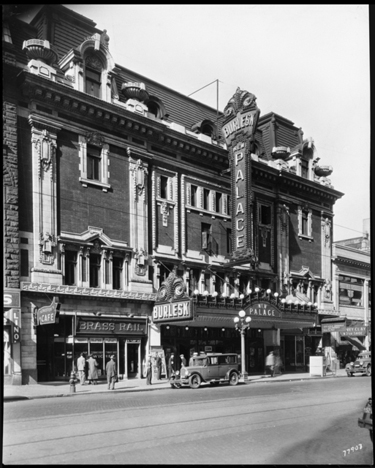
Palace Theater, October 7, 1928. Photo courtesy Minnesota Historical Society
CinemaTreaures.org:
By 1934, under independent management, it was once again showing a mix of vaudeville acts and motion pictures, as in its early days. In the mid-1930s, the Palace Theater was the first major downtown house to present a double feature format, which continued through most of the rest of the decade.
Millett:
By the mid-1930s the theater had become a popular venue for wrestling.
In what probably does not rank as one of civilization’s great moments, on September 8, 1938, the theater offered “the first ice cream wrestling bout to be presented anywhere,” according to the Minneapolis Star. (September 6, 1938)
This epic encounter pitted experienced mud wrestlers Roughhouse Ross from St. Paul, against Jumping Joe Reno from New York, in a “sideboard ring” filled with 250 gallons of ice cream. It’s not known what flavor of ice cream was used or who won the match, but a crew from the Universal Newsreel was supposedly on hand to film the slippery action.
On November 26 and 27, 1938, new cowboy star Roy Rogers appeared onstage at the Palace Theater, with three singing cowboys. His first film, “Under the Western Sky” was premiered on the screen. (Minneapolis Star, November 24, 1938)
On May 4, 1939, wrestlers tangled in a vat full of molasses and popcorn – vying for the prize were Roughhouse Ross and Cowboy Watters. Mud wrestling rules applied.
CinemaTreaures.org reports that the Minnesota Amusement Company took over the theater in 1940 as a no-frills second-run house.
The Palace Theater’s last show was on May 11, 1953

Palace Theater, May 25, 1953. Photo courtesy Minnesota Historical Society
The Palace was razed during the summer of 1953 to make way for a parking lot.
The sad caption on the photo below reads:
Once a proud theater where some of the biggest names in show business of a bygone era appeared, the Palace theater, 414 Hennepin Avenue, is shown as the wrecking of the building nears completion. In this picture, which looks towards Hennepin Avenue from the alley behind the building, the crane stands where the stage once was located. The steel cross-beams held the gallery seats. The area where the building stands will be converted into parking lot when the wrecking job by the Federal Lumber and Wrecking Co. is finished. The job is expected to be completed by August 1. (Minneapolis Star, July 15, 1953)

Minneapolis Star, July 15, 1953
THE BASEMENT OF THE PALACE
Although the addresses are inconsistently given, it appears that there was a basement in the theater that was generally given the address 414 1/2 Hennepin Ave. That space grew from a lunch deli to a full-fledged night club during its 38 year existence. In the photo below, the end of the theater furthest away from 4th Street looks like it would have been the entrance to the basement. Those clubs are detailed on the Gay ’90s page.

This iconic workingman’s bar at 500 Cedar Ave. has a long, storied history. Some research for this page was done by Philip Reinhardt, who generously posted it on Facebook and has given me permission to use here.
I have a hard copy of an early permit card, kept by the Minneapolis Inspector of Buildings, but for some reason can’t bring the address up online. The card I have indicates that the address of the building was 500-02 Cedar Ave. It is not the first card, as it starts in 1905.
In 1886, Stanley Utter ran a confectionery at 500 Cedar Ave. This information comes from a directory listing.
On April 9, 1896, a confectionery and cigar stand were advertised for sale at this address. The ad offered the place “for sale cheap; good location, low rent.” (Minneapolis Tribune)
In April 1905 the permit card said that part of the building was a Bicycle Shop.
In October 1905 the permit card said it was an office, but see this ad from the same month:
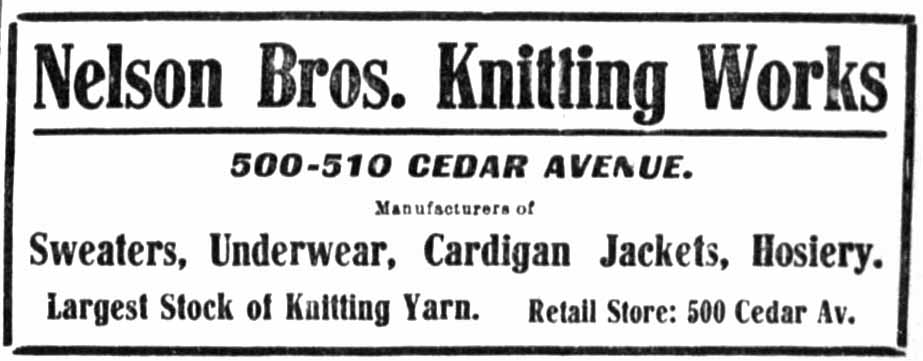
Minneapolis Tribune, October 6, 1905
SALOON
In March 1906, the building was altered and made into a saloon and flat, consistent with the permit card.
Notice in paper:
Lindquist & Noren, Bank of Commerce building, have let the contract for improvements and a new store front in the building at 500 Cedar avenue for the Minneapolis Brewing company. Boehme & Cordella, Architects. Cost, $2,500. (Minneapolis Journal, April 15, 1906)
This coincides with the notation on the permit card, which says alteration to store, with the same dollar amount.
In general, a saloon was for men only – a place to drink and spit and tell lies. It was the saloons that ticked off the women, whether it was because their men were not at home, they were spending the rent money on beer, or maybe because the women resented not being welcome.
The new saloon was a “tied” establishment, serving only products made by the Minneapolis Brewing Co., later known as Grain Belt Beer. Like many other such Grain Belt bars, a distinctive tile flooring was installed, which is still in the building today.
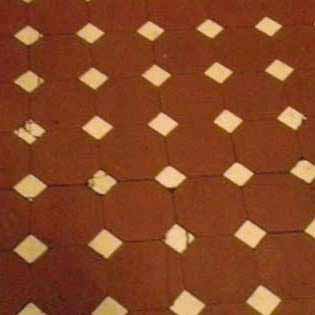
From Palmer’s website
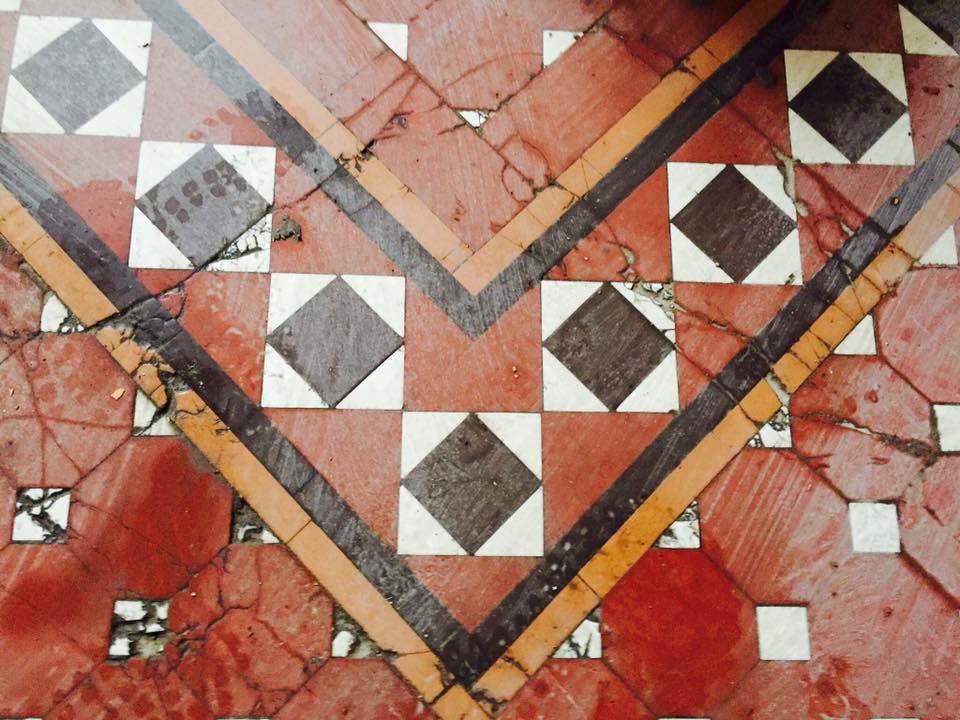
More Grain Belt Tile from the Viking Bar
You can still see the distinctive Grain Belt floor today:
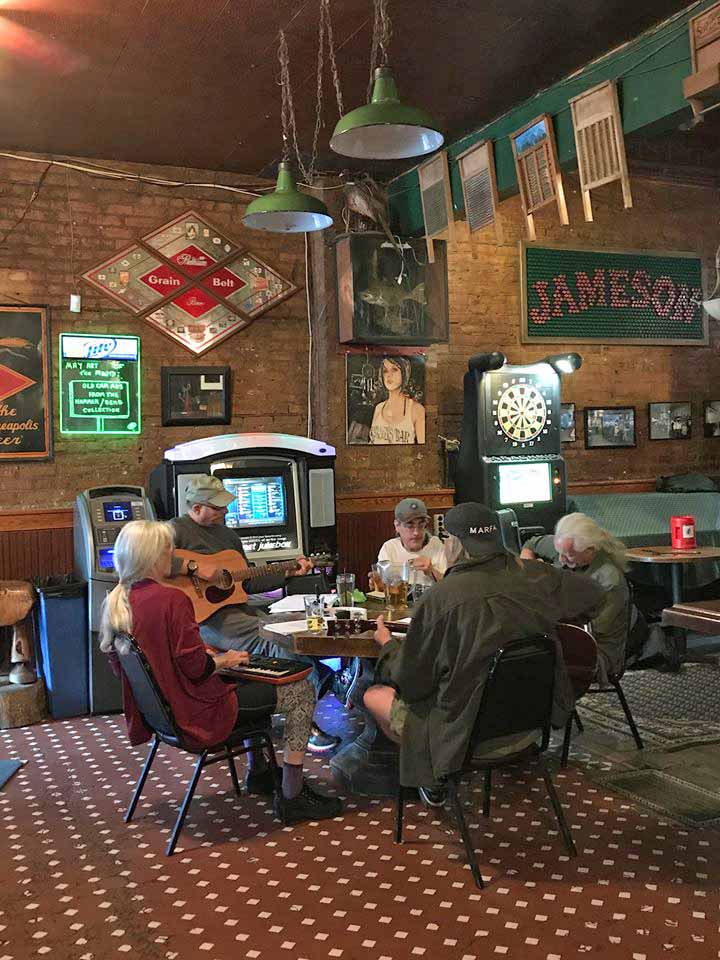
Photo courtesy Philip Reinhardt
PROHIBITION
Prohibition went into effect in January 1920. The permit card indicates that the saloon transitioned to a store/restaurant/lunchroom/cafe.
On January 26, 1926, an ad appeared for a cook, “1st class, Scandinavian woman preferred. Also dishwasher.” (Minneapolis Tribune)
In 1932 the restaurant was for sale: “fully equipped with counter, stools, booths, $600 cash.” (Minneapolis Tribune, February 7, 1932)
BACK IN BUSINESS – CARL’S BAR
Prohibition ended when beer was legalized on April 7, 1933. Each municipality handled hard liquor licenses as they saw fit. The first places were generally known as taverns, and this time women were welcome. The permit card shows that a permit to install plumbing for a bar was pulled on April 20, 1934.
One day in the 2010s, a woman came to Palmer’s to celebrate her 100th birthday. She brought photographs of the bar from the 1930s when her father had owned it; at the time it was called Carl’s Bar. (Star Tribune, September 21, 2015 – obituary of Keith Bergy by Natalie Daher) The following photos are from the bar’s website, and are the best I’ve seen of a 1930s tavern/bar.
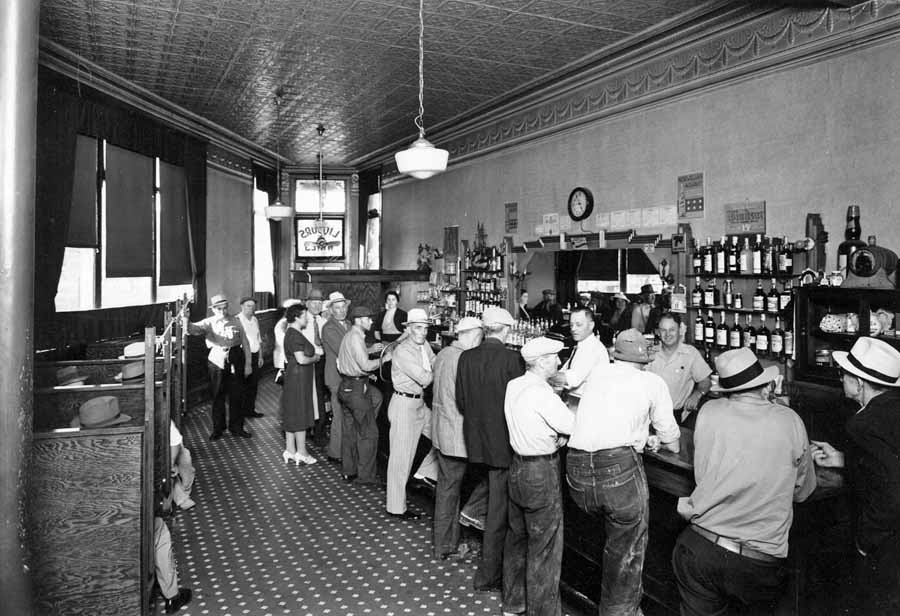
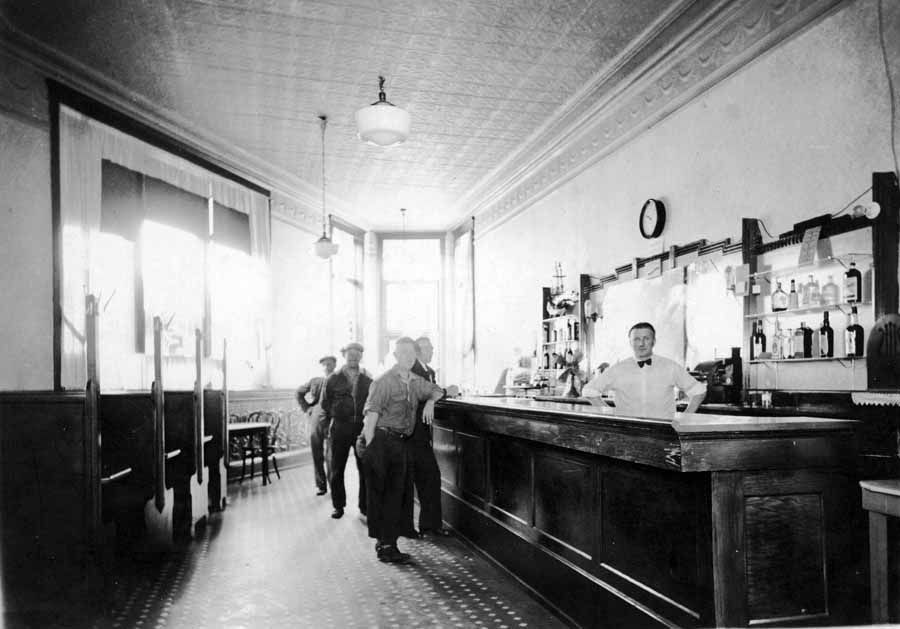
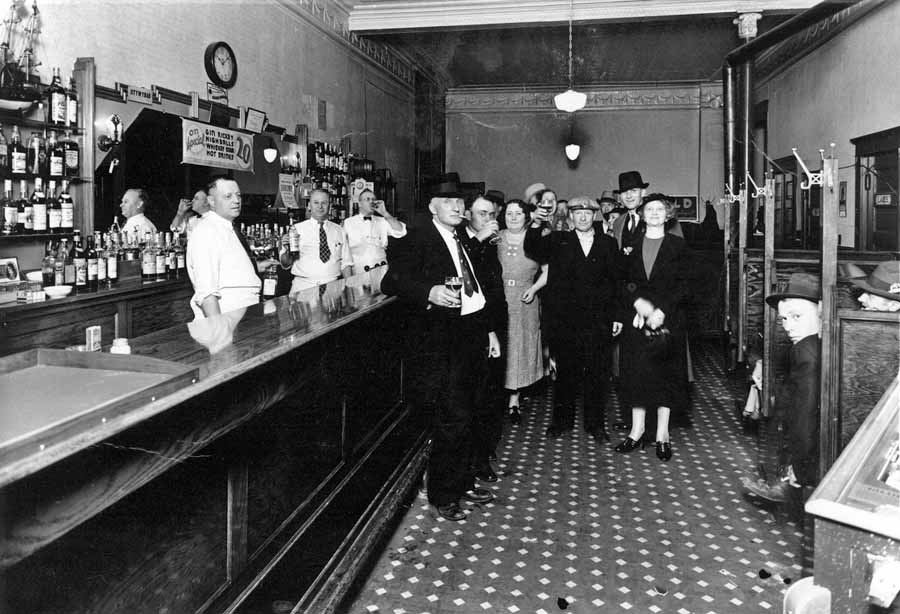
BOOTS NELSON’S
On December 1, 1947, a news item entitled “Stickup Man Asks $55 Question, Wins” tells us that the place was called Boots Nelson’s Bar.
As Elmer Nelson, manager of the bar, left the place at about 3 am, a stickup man accosted him and asked, “How much money have you got?” Nelson said he had $55. The holdup man warned, “That better be what you give me.” It was. (Minneapolis Tribune)
A 1948 article revealed that the former owners of Boots Nelson’s Bar were Elmer N. (Boots) Nelson and Mrs. Leonilla L. Berman. Mrs. Berman was the wife of Ockie Berman, “Floor Man” at the Variety Bar, 830 Hennepin Ave. Nelson said they had sold out to someone named Palmer – he didn’t remember his first name. The liquor license division at city hall reported a transfer of the license for Boots Nelson’s was being made to Mrs. Virginia C. Palmer. She formerly owned a tavern at 2519 E. 25th Street. (A commercial building that was built in 1966 sits there now.) (Minneapolis Tribune, July 24, 1948)
PALMER’S
Determining when the bar actually became known as Palmer’s is no easy task.
It was still Boots’ in December 1947.
Boots sold out to Palmer before July 1948. Mr. Palmer appears to be Henry Edward “Bud” Palmer (11/6/1897 to 1/13/1964).
An article on Adam Folta, an immigrant from Czechoslovakia, says that he had owned the bar for 27 years but doesn’t say which 27 years. It does say that in 1988 he’d been retired for 14 years, which means he retired in 1974. 1974 minus 27 years means he bought the bar in 1947. (Minneapolis Tribune, June 26, 1988)
An article from 2015 says that it’s been Palmer’s since 1950.
“Quiet Customer Gets a Beer, Pulls Gun and Takes $200.”
Seems a tall man came in and sat on a bar stool and ordered a beer. After bartender Melvin Swanson served him, the man pulled out a .45 automatic, pointed it at Swanson, and said “Do what I tell you or I’ll plug you.” Swanson emptied two cash registers, giving the man $200 in paper money. The robber got the last word, saying “Now you can call the cops” as he fled. Customers never saw the gun and thought the bartender was just making change. (Minneapolis Tribune, August 4, 1954)
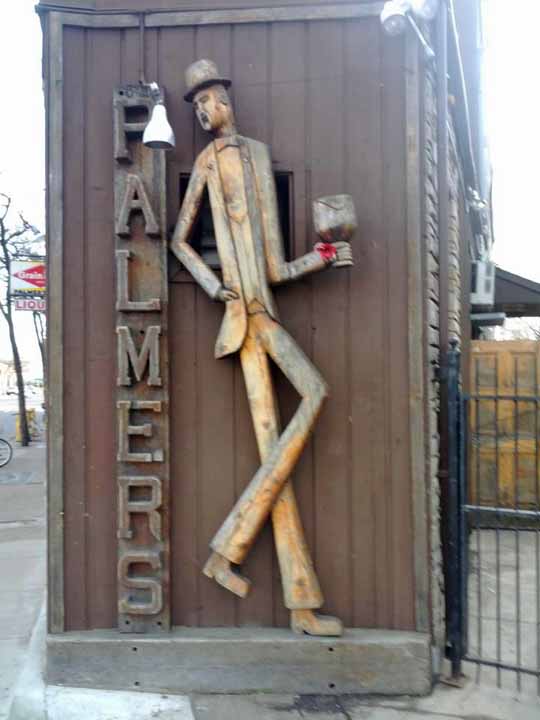
Who is this man?
“Coughing Victim Injured in Fall”
Einar Johnson, about 64, 1100 S. Eighth Street, was taken to General hospital in critical condition after falling on a stone floor at 500 Cedar avenue. He suffered head injuries when falling during a coughing spell, police said. (Minneapolis Tribune, December 26, 1956)
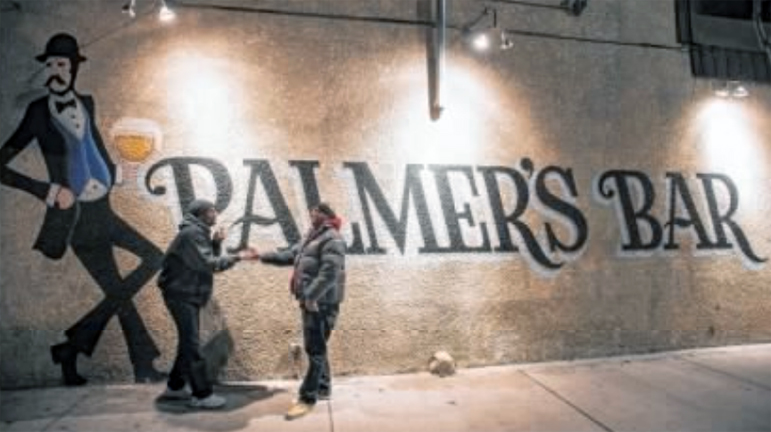
Minneapolis Star Tribune, December 31, 2015. Photo by Aaron Lavinsky
In 1973, former bootlegger Don Carmichael was the proprietor of Palmer’s and anticipated a boom in the Cedar-Riverside area. But business was so bad by December, he had to lay off his bartender. “Who do I need? A bartender? I can drink as much as he can.” (Minneapolis Tribune, December 9, 1973)
Adam Folta retired in 1974 and sold the bar to his son Roger. (Minneapolis Tribune, June 26, 1988) Roger is said to have owned it from 1975 to 1996.
Florence Johnstone was a co-owner since 1981.
Two men were stabbed outside Palmer’s bar on September 16, 1987, and treated at Hennepin County Medical Center. (Minneapolis Tribune, September 17, 1987)
For the movie Old Explorers, first-time director Bill Pohlad transformed Palmer’s into a 19th Century British pub. The one review of this film on imdb.com says it has a “bargain basement look and feel to it.” Ouch. Pohlad was criticized for using his wealthy father’s money to buy his way into Hollywood. (Minneapolis Tribune, August 31, 1989)
Minneapolis’ record-breaking 62nd homicide of 1991 occurred during a fight outside of Palmer’s Bar on December 30, 1991. The long-standing dispute may have been about a woman. (Minneapolis Tribune, December 31, 1991)
A stolen wallet led to a murder-suicide on November 3, 1995. (Minneapolis Tribune, November 5, 1995) The area was getting more and more dangerous, and stores were going out of business or closing early.
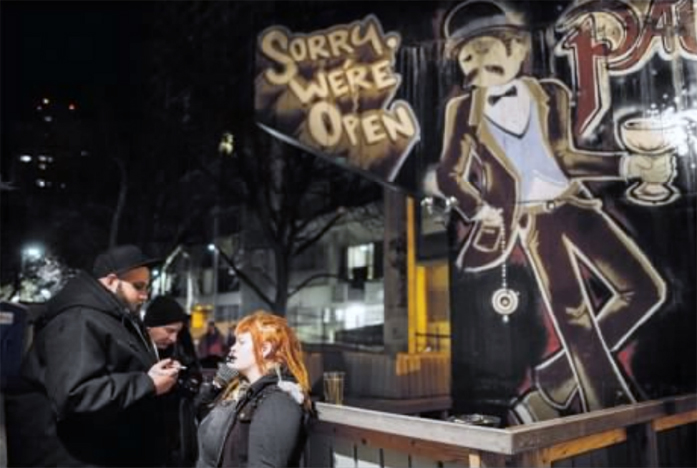
Minneapolis Star Tribune, December 31, 2015. Photo by Aaron Lavinsky
The bar was purchased by Keith Berg and his wife, Lisa Hammer in 2001. Berg had previously been a bartender there. Originally from North Mankato, Minnesota, Berg moved to Minneapolis in 1977 to attend the U of M. (Minneapolis Tribune, September 22, 2015)
A man was found dead in the bar’s parking lot on May 16, 2002. (Minneapolis Tribune, May 17, 2002)
The French-Norwegian film Factotum was filmed partly in Palmer’s Bar in 2005.
Another dispute led to yet another deadly shooting in front of the bar on June 3, 2007. (Minneapolis Tribune, June 5, 2007)
Palmer’s was named one of the best bars in America by Esquire magazine in 2014. (Minneapolis Tribune, September 22, 2015)
September 2015: Owner Keith Berg died unexpectedly at the age of 56. More than 500 people attended his funeral. His widow, Lisa Hammer, continued to be a co-owner of the property.
In May 2018, co-owner Lisa Hammer sold her ownership share to Tony Zaccardi, who spent many years as a part-time bartender, and was the bass player in the bands Romantica, Eleganza!, and Coming Collapse.
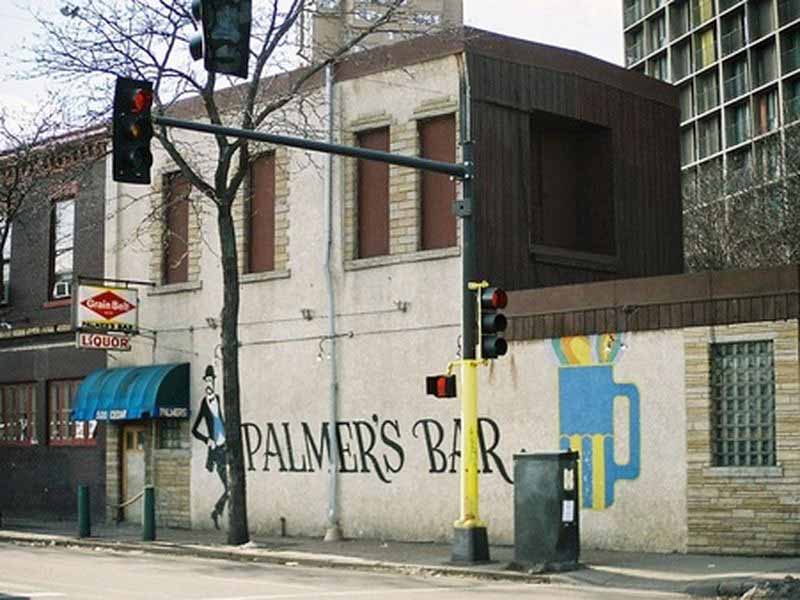
GOD BLESS YOU, PALMER’S BAR
On July 25, 2014, the City Pages published a love story to Palmer’s Bar written by Zach McCormick. Mentioning the rash of murders in the late 1980s and early 1990s, McCormick said that Palmer’s “didn’t even blink.” Here are some excerpts:
Palmer’s was a skid-row fishtank during the dark ages of Cedar Riverside in the 1950s. In the ’60s and ’70s, it became a hub for the beatnik and hippie movements, drawing in bohemians and ivory-tower wannabes from the nearby universities with a burgeoning folk and blues community. One of Bob Dylan’s most important mentors, “Spider” John Koerner, made the bar his stomping grounds and is still playing the annual summer festival, Palmfest.
His partner in crime, Dave Ray, showed Bonnie Raitt the ropes around there during the early 1970s with the help of blues legend Willie Murphy. Piano player “Cornbread” Harris (father to Jimmy Jam) has called Palmer’s home since he played on “Hi Yo Silver,” the first rock ‘n’ roll single to be recorded in Minnesota, back in 1955.
FROM PALMER’S WEBSITE
Palmer’s was a second home to dock, rail and lumber workers, boat crews, immigrants, gadflies and transients.
Rumor has it there was a tunnel connecting Palmer’s to the 5 Corners Saloon.
Palmer’s is still a proud second home (community center with a kick) to many a working Twin Cities man and woman, including: students, nurses, cabbies, hippies & hipsters, musicians, anarchists, poets and artists, as well as a rare breed of professional barflies
Palmer’s has been described as: A church for down and outers and those who romanticize them, a rare place where high and low rub elbows – bums and poets, thieves and slumming celebrities. It’s a place that wears its history proudly.
Palmer’s is a destination where you can occasionally find a pick-up Scrabble game, a free-form Hippenanny (every Wednesday around 5) and where you can always find a familiar face, an interesting conversation and the best drink values in the Twin Cities!
Please see the Cotton Club at 718 Sixth Ave. No.
The Pantages Theater is at 700 Hennepin Ave., Minneapolis. From the website of the Hennepin Theatre Trust, which owns the theater:
The Pantages, which now seats 1014, opened in 1916 as a vaudeville house and part of Greek immigrant and impresario Alexander Pantages’ renowned consortia of theatres. It was designed by the Minneapolis firm of Kees and Colburn in an Art Moderne/Beaux Arts style. The Pantages’ first show was a vaudeville lineup that included singers, comedians and a banjo player.
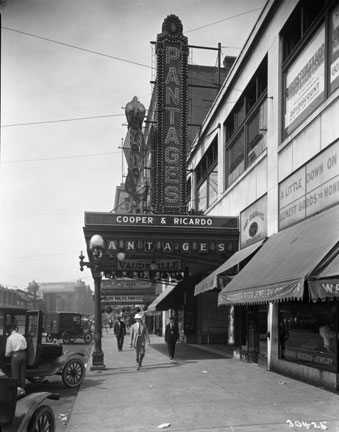
Photo from 1920 courtesy Minnesota Historical Society
In 1922 the Pantages was remodeled by renowned theatre architect Marcus Priteca/RKO and a new stained glass dome was added, which remains among the Pantages’ most lovely features. In 1945 Edmond Ruben purchased the Pantages and renovated it by adding bird’s-eye maple. The grand reopening was on April 14, 1946 with a screening of “Gilda.”
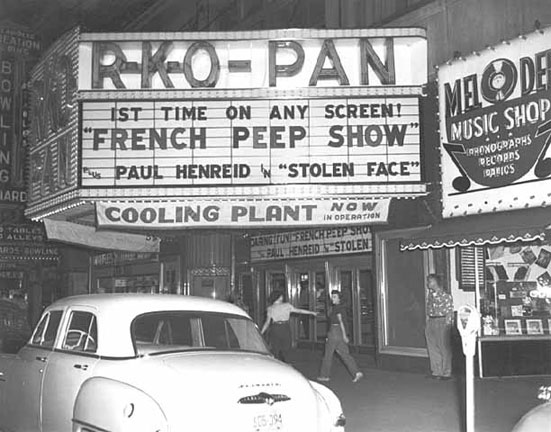
In the 1950s it was the RKO Pan. Photo from 1952 courtesy Minnesota Historical Society
In 1961 Ruben sold the Pantages to Ted Mann, who owned five other downtown Minneapolis theatres including the Orpheum Theatre. Mann renovated the Pantages yet again, and reopened it as a top-notch movie house the Mann Theatre on March 15, 1961, with the movie “Spartacus.” That same year, United Artists previewed “West Side Story” at the Mann and the film went on to win ten Academy Awards. In 1965 director Robert Wise, recalling his success with “West Side Story,” decided to preview his new movie, “The Sound of Music,” at the Mann. The showing at the Pantages was a terrific success and went on to become the longest running film in Twin Cities history – just under two years. The theatre operated sporadically from 1965 through 1984, continuing to show movies including the Mann’s last Twin Cities premiere of “Annie” in 1982.

Ted Mann, 1966 – photo courtesy MHS
In 1984 the Mann Theatre closed and remained shuttered until 1996, when current Hennepin Theatre Trust President/CEO Tom Hoch and former Historic Theatre Group President Fred Krohn initiated a five-year effort to save and restore the Pantages Theatre. During the renovation, architectural drawings were found and used to restore much of the theatre’s decorative plasterwork and character. The stained-glass “monitor,” a false skylight in the center of the auditorium’s ceiling, was revealed after layers of paint were removed. In cooperation with the City of Minneapolis, on November 7, 2002, the completely renovated Pantages re-opened at a cost of $9.5 million. Since then, the intimate Pantages has presented music, theatre and dance artists including Mikhail Baryshnikov, Vince Gill, Feist, Todd Rundgren, The Blenders and collaborative productions with Twin Cities’ organizations including the Jungle Theater, the History Theatre, Chanhassen Dinner Theatres, Cantus and Theater Latté Da. Hennepin Theatre Trust is now the owner and operator of this magnificent structure.
This brick building at 325 West Broadway in Minneapolis was built in 1903.
NORTHERN BAR & CAFE
The Northern was a ’30s night club that had some unusual features. The bar had beautiful fish and live alligators in their natural haunts. View Harvey Kruse’s famous collections of northern Minnesota scenes. What could that mean?
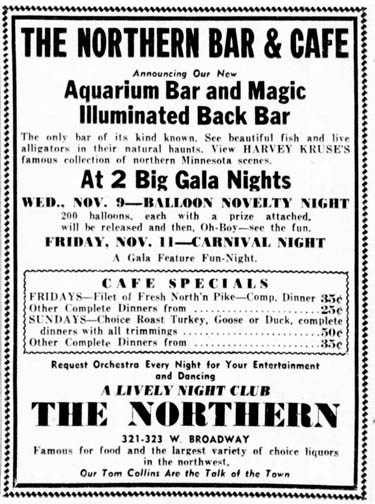
Minneapolis Tribune, November 9, 1938
The Northern was advertised for sale in December 1941.
In June 1948 the owner was Stanley Daszkiewicz.
PAPA JOE’S
Sherwin Linton said, “I played Papa Joe’s Northern Bar in 1959 when we were the Fender Benders. We had been playing the 311 Bar next door on Broadway and had the placed packed, so Papa Joe hired us. The 311 was just a 3.2 beer tavern so the Northern was a big step Up.
Will Jones noted on March 2, 1964, that although the place was being billed as Papa Joe’s, the sign outside still said the Northern Bar. Augie Garcia was performing there at the time. He said the bar had been featuring rock ‘n’ roll previously, but Augie was mixing in some jazz, Latin and show numbers.
Papa Joe was Joseph Daszkiewicz, who also owned the Sandpiper Inn. He was also a boxing promoter, manager, and trainer of professional and Golden Gloves boxers. He and his wife Rita had ten children. He died in 2003.
At Thanksgiving 1964, Papa Joe invited us to the Northern Supper Club.
BANDS AT PAPA JOE’S
Bruce Pedalty recalled that “the Dorados did a stint there as the house band, in the ’60s . Music lore had it that Gary Neilson had a bullet hole in his B3 from gunfire inside the club.”
Joel Geris remembered that when you walked in the back door the air conditioner would leak on the back of your neck. In the window the poster said “The Stars of Tomorrow today.” Joey Strobel and the Runaways were playing.
THE STARLINERS
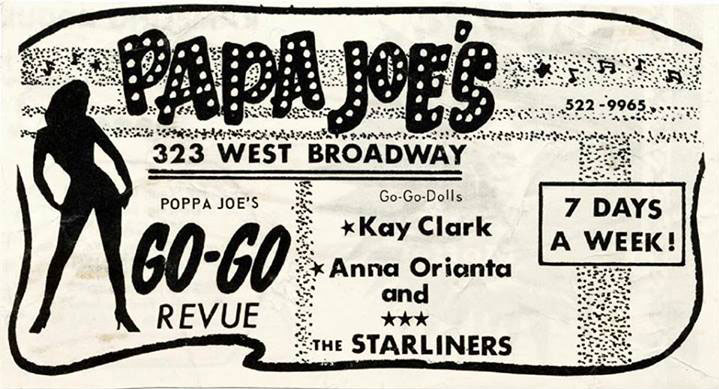
Ad courtesy son Joe Daszkiewicz
In 1966 the Starliners made a live album at the club. Band member Keith Zeller tells us that the members were himself on guitar, vocals, and piano; Jack Kollodge on bass and vocals; and John Rosner on drums and vocals. Keith says the LP was recorded “Live with no over dubs!!” This extremely rare album is showing availability on Discogs.com….. for $1,200!
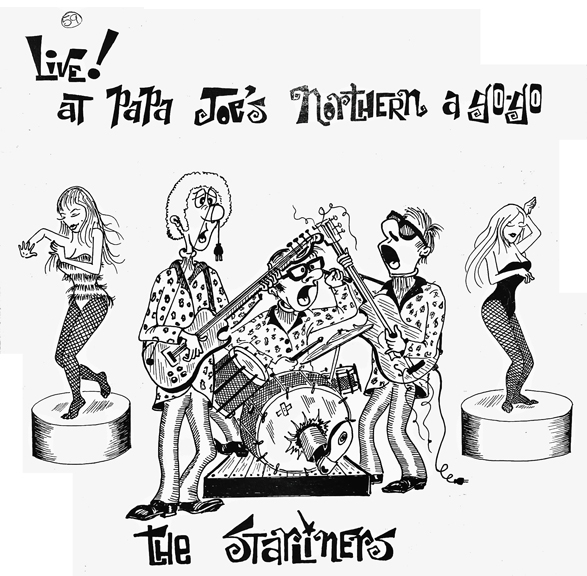
In October 1967, the Tributes entertained, with Go-Go girls.
Joe Scanlan: “I played at Papa Joe’s many a time in the day! My band was the Rush Hour…Ross Ingram, Chuck Edwards and myself. The Go Go girls started at 4 PM and we would begin at 8:00. Great memories. As stated above, Papa Joe was a boxing promoter. On any given night there might have been as many as three or four boxers in the club. And yes many of them drink milk!”
Speaking of boxers, Eddie Shaw says, “I played there in 1969 with Rick Odell (can’t remember all the names). I was slugged by a resentful boxer (waiting for me) the end of the night as I was walking out. Papa Joe banned him from entering the club again.”
Bill Swanson says he “was with the House Band at Papa Joe’s in early ’70s with my band Treadwood. Found friendship with one of the go-go girls. Witnessed some crazy stuff there.”
Papa Joe’s ads seem to stop in January 1972.
From then on, the name seems to have reverted to the Northern Bar.
On February 12, 1972, a policeman was shot in the back behind the Northern Bar.
A fire hit the building in March 1973; the article identified the first floor as the Northern Bar. A permit to demolish the building was pulled on March 20, 1973.
It’s now an on-ramp to I-94.
Parade Stadium was located in a Minneapolis City Park called the Parade.
The name dated back to 1904 when some of the land was next to the Kenwood National Guard Armory (demolished in 1934), and was used as a parade ground by the guard.
Construction of the current stadium began in 1950. It was temporarily halted due to a Korean War construction moratorium, but the City got an exemption and the stadium opened in the summer of 1951. The stadium was planned as a 17,000 football stadium with 600 parking spaces; there was also a 4,000-seat baseball stadium.
The first major event at the stadium was a 1951 Aquatennial appearance by the Lone Ranger and his horse, Silver. For many years Parade Stadium was the starting point for both Aquatennial parades each year.
Parade Stadium was the site of many outdoor concerts and festivals in the ’60s and ’70s: 30,000 people came to a Melissa Manchester concert in June 1976, and the gates were crashed and the goal post bent during a near-riot at a Fleetwood Mac concert. The last major concert there featured Simon and Garfunkel in July 1983.
An ice arena and Sculpture Garden were built in 1988, and the changes edged out the aging stadium. Parade Stadium was demolished in 1990. The park remains, at Hennepin Ave. to I-394, between Vineland Ave. and Wayzata Blvd. It is 45.77 acres, including 2.32 acres of water. This is 21 acres less than the original park, due to land lost to the construction of I-94 and I-394.
Minneapolis Park Historian David C. Smith has written a very detailed history of Minneapolis parks, including Parade Stadium. Also see the entry on Minnopedia, also by Smith.
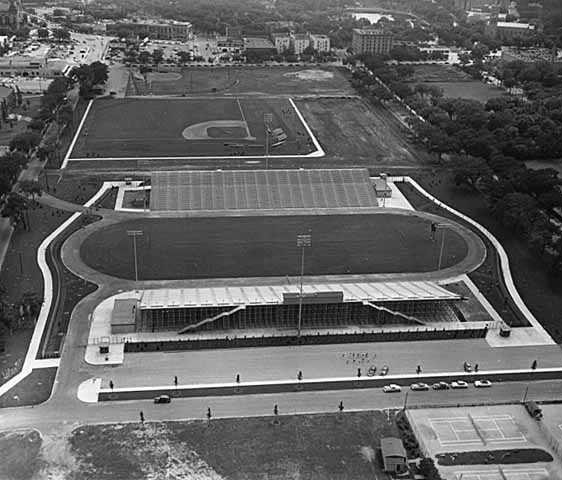
The Parade complex, 1952, courtesy Minnesota Historical Society
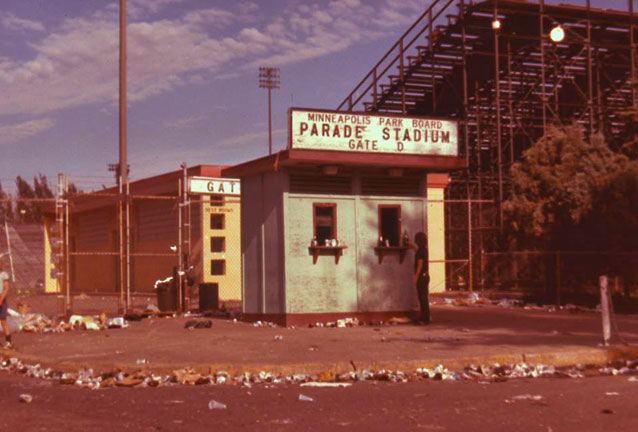
Post-event photo from 1977, courtesy Alan Freed
Please see the Gay ’90s for information on this venue.
The Paradise Cabaret, 414 1/2 Hennepin Ave., opened in 1935 and closed in 1939. Please see the Gay ’90s for more information.
The Paragon in Coon Rapids was an over-21 club opened by musician Ceedy Van Dusen and Gary Finch in May 1968.
The Paramount Inn/Cafe was located on Rice Street and County Road E in St. Paul.
In 1940 you could dine and dance to Bill Dietrich’s Orchestra, two floor shows nightly, plus Hawaiian entertainers on Monday nights. In November 1944 they promised entertainment every night.
The Park Nite Club was located at 188 N. Snelling at Selby in St. Paul.
First hit in the Minneapolis papers was in February 1938, giving the bowling report.
On Halloween 1938, you could be entertained by “Pa” Trester and his “Screwballs.”
For two weeks only 1947! Al Trace and Lee Pines! America’s Greatest Dance and Comedy Band.
Here’s Roy King’s Komi-Kings, the Kraziest Komedy Band in Kaptivity!
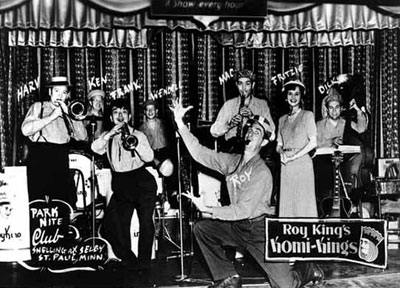
1955 photo courtesy Minnesota Historical Society
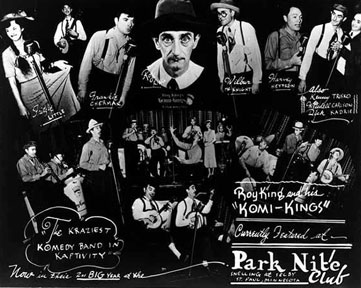
1955 photo courtesy Minnesota Historical Society
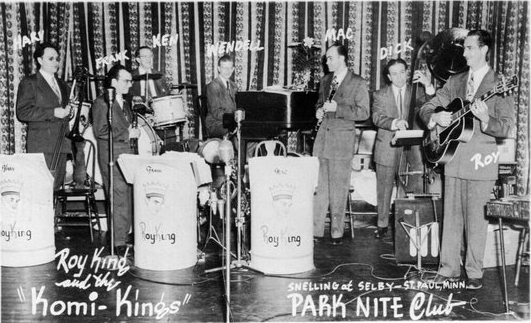
Komi-Kings at the Park Nite Club – Date, Provenance, Comedy, unknown. Courtesy Derik Olson
This bar/restaurant, located at 4700 Excelsior Blvd. on the St. Louis Park entertainment strip, hosted many venues, including:
- The Park Terrace
- George’s in the Park
- Duff’s in the Park
- Infinity
- Classic Motor Company
SITE HISTORY
The property at 4700 Excelsior Blvd. started out as a drive-in back in the 1920s, owned by Donovan and Kelly.
In 1932 it was the Yum Yum Root Beer Stand run by Mr. Donovan, although there is an indication that there was also a vegetable stand at the site, owned by Clarence Eggers.
At one point, probably in the 1930s, it was the Root Beer Garden, run by Robert Johnson, whose Family Garden was located across Excelsior Blvd.
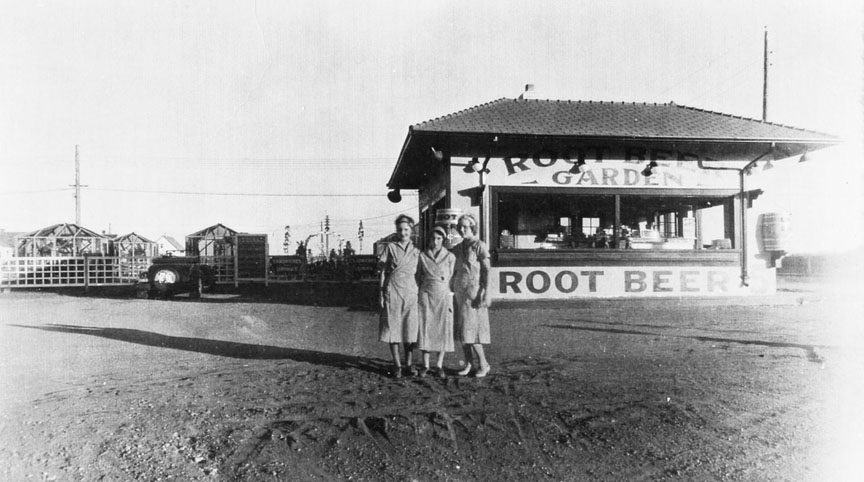
Image courtesy St. Louis Park Historical Society
In 1939 the owner was listed as A.G. Larson.
In the early ‘40s it was the Molzahn Drive-In, run by Fred Molszahn.
In August 1949 The Chicken Basket opened: “Our chicken is so southern fried it has a drawl!”
From June 6-15, 1950, one Sidney Katz, dba City Banana, Inc., got a license to sell fruits and vegetables on land owned by Peter Kosmas.
A newspaper ad in November 1950 touts the Circus Poney Drive-Inn, apparently owned by G.H. Hopfenspirger. How a drive in would work in Minnesota in November is puzzling. The circus ponies were the kind with springs, and one was given away free each day for 25 days.
In 1952-54 the site was known as the Boulevard Drive-In and featured A&W Root Beer.
PARK TERRACE
In 1956 Peter George Kosmas and his brother-in law, Anthony J. Kallas, who had managed Jennings Tavern, built and established what was first called the Park House Tavern but soon became known as Park Terrace Cafe and Bottle Shop. The building cost $225,000 and was originally of stucco construction.
Helping to establish Park Terrace were George P. Kosmas (father of Peter Kosmas and father-in-law of Tony Kallas.) Bill Kordaris was maitre d’ there in the ’50s.
Park Terrace was a fine dining, white tablecloth kind of establishment, and became known as the Park Terrace Supper Club. The June 1963 Twin Citian described “Dancing nightly in the main dining room,, plus entertainment each evening in the piano bar. Attractive menu features Mandarin Dinner for Two.” This business lasted until about October 1966.
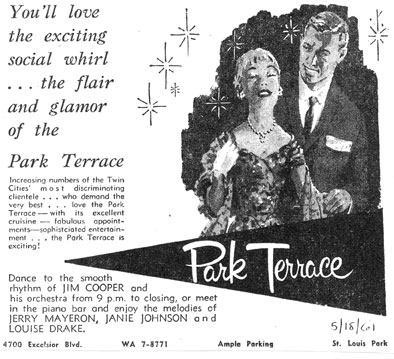
May 18, 1961
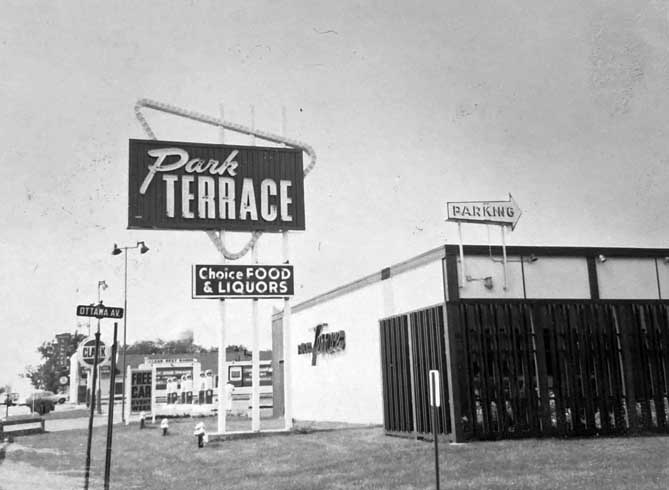
1960s Photo courtesy Jim Kordaris
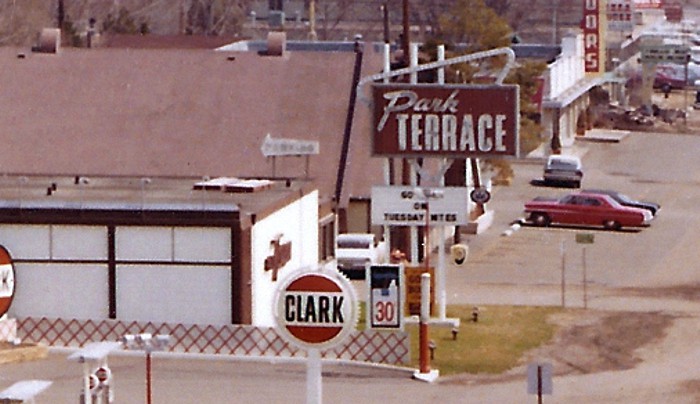
On October 17, 1966, Peter T. Kosmas, owner of the Park Terrace, sold the building to George Schaumburg and his silent partner, Patrick Moore, both of Minneapolis. The liquor licenses were transferred and the building was closed for remodeling for about six weeks. Schaumburg had been connected with several bars in the Twin Cities, including the Flamingo, the Office, and the Red Carpet, according to an account in the Dispatch dated October 13, 1966.
Before transferring the liquor licenses, the St. Louis Park City Council expressed concern that the establishment would be operated as a “private club,” which was a trend at the time, in which one had to have a membership card to be admitted. Schaumberg said that this would not be the case. Schaumburg’s attorney, William McKostie, also said that entertainment would continue in the “easy listening” vein. “Something you can eat dinner to that doesn’t beat your head to death.”
GEORGE’S IN THE PARK
In December 1966 the restaurant reopened as George’s in the Park.
Will Jones commented on a unique feature of the place; there was both a room marked Ladies and one for Women. Schaumberg explained that he had to add more facilities because of overcrowding. The difference was that the Ladies room had an attendant and the other didn’t.
The place might have gotten a little rough; people report that management saw it necessary to post a sign on the door saying “No Buck Knives.”
There is one sketch of the building on file that indicates, and it has been confirmed, that there was a sauna in the basement!
In 1967 the off-sale liquor store was removed in order to expand the club.
Vicki and the Tornadoes opened the club and performed there six nights a week until the spring of 1968.
JOEY STROBEL AND THE RUNAWAYS
Joey Strobel and the Runaways followed as the house band for about three years. In an interview with minniepaulmusic.com, Joey described a stainless steel dance floor and a light show controlled on the stage by Joey. On stage, Joey usually wore a grey sharkskin suit and a black shirt with a black tie. At one point in time the band members all wore powder blue vests and platform shoes. At one point in time, a manager at Georges in the Park convinced the group to wear Canary yellow suits, even though Joey disliked the look.
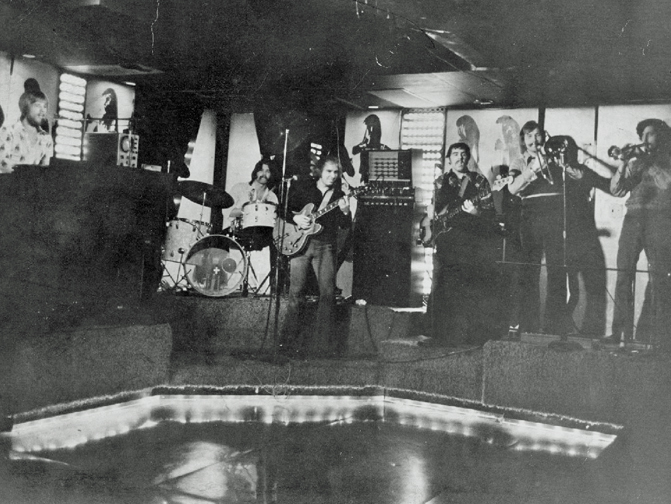
Joey Strobel and the Runaways at George’s in the Park. Photo courtesy minniepaulmusic.com
The band performed at the club:
- February 11, 1968 to November 24, 1968
- June 3, 1968 to July 22, 1969
- January 18 to September 13, 1970
- September 7, 1971
- October 10, 1972 to April 2, 1973
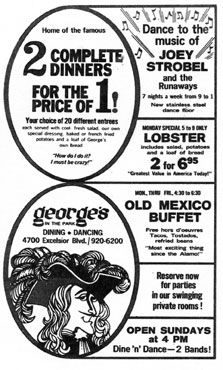
1970
On June 6, 1970, Jeff Lonto’s aunt’s graduation from St. Margaret’s Academy included dinner at George’s In the Park. Jeff shared some photos from this event that give us a glimpse inside and a look at the band!
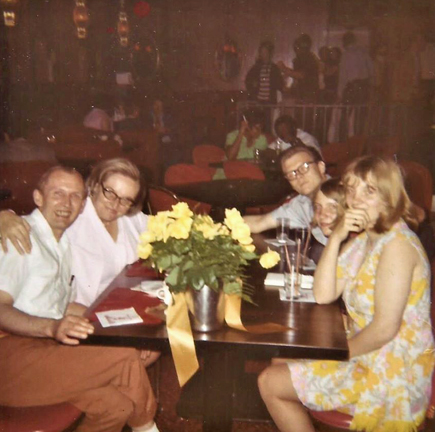
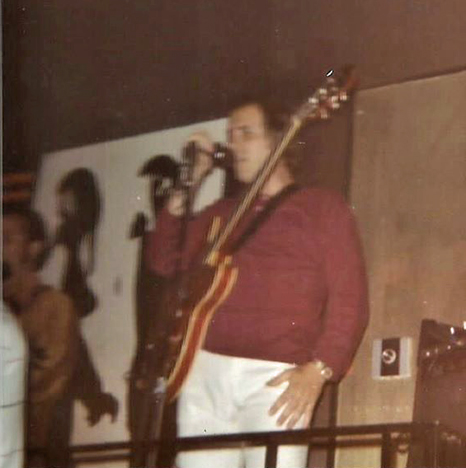
Joey Strobel? Photo courtesy Jeff Lonto
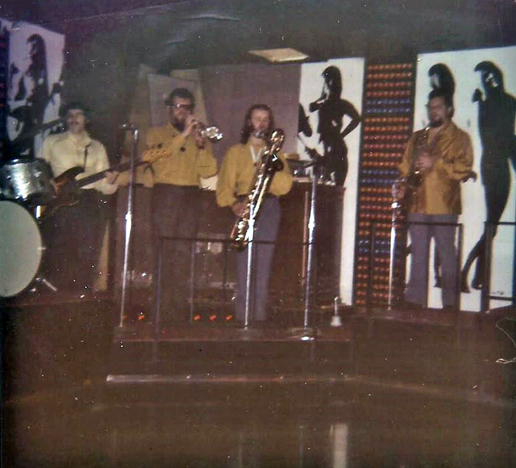
The Runaways! Photo courtesy Jeff Lonto
In 1972 the fire chief sent a letter citing many complaints of overcrowding. In fact, the City Council went so far as to try to ban live music in Park bars to keep down the traffic. In February 1972 the manager was Jack Conrad and the club was on Playboy magazine’s list of places to go, says the Insider.
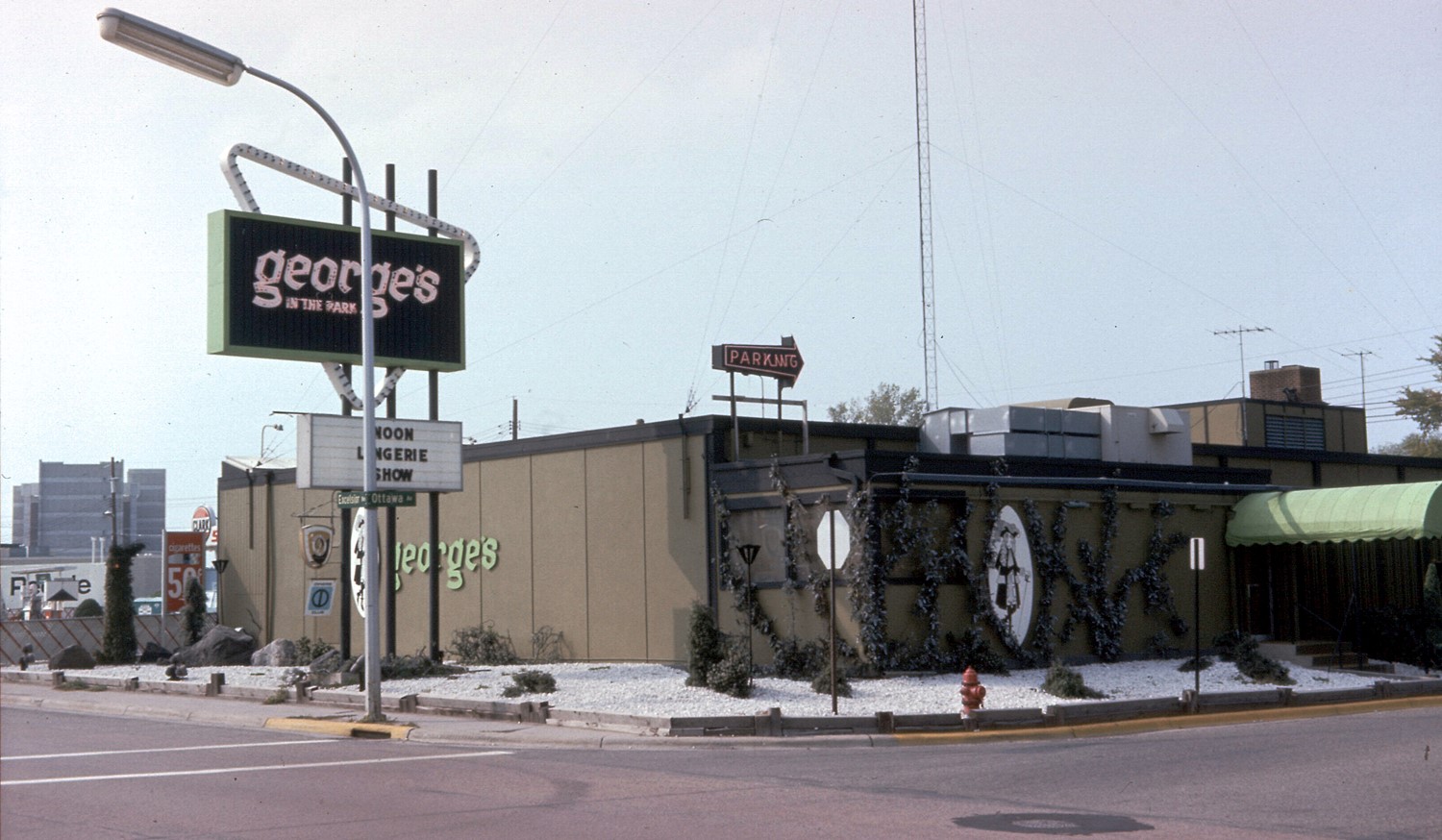
DUFF’S IN THE PARK
In November 1971, a Hennepin County District Court Judge awarded Joseph P. Duffy, Jr. half interest in George’s in the Park. (Minneapolis Star, November 6, 1971)
George’s in the Park became Duff’s in the Park in about December 1973, although Joseph P. Duffy, Jr. and his partner John Anzevino were initially denied a liquor license by the City of St. Louis Park after some concerns about political contributions. The SLP Dispatch listed an impressive list of lawyers: Gerald M. Singer, Ronald Meshbesher, Kenneth Meshbesher, and Russell Spence. Duffy owned Duff’s downtown (21 South 8th Street) for 14 years and was a co-owner of Duffy’s Bar (26th and 26th) for 10 years.
Although it was billed as all new, the picture of Mr. Duff on the ads was the same as Mr. George, and Joey Strobel was still the house band.
In January 1976, Duff’s got in trouble for holding wet t-shirt contests in which the contestants often removed said garments. Duff sold the business to Papa’s Inc.: brothers-in-law William Howell and Burton Rozman.
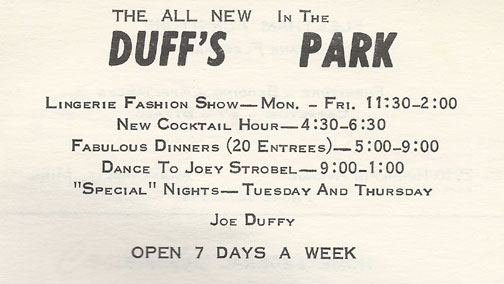
1974 ad in Holy Family Catholic Church cook book!
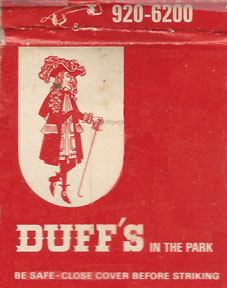
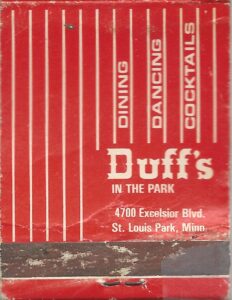
INFINITY
Duff’s in the Park became Infinity on November 16, 1976. A November 4, 1977, article in the Minneapolis Tribune says: “Draws a very mixed-age crowd, everyone from teen-agers to middle-aged couples. Seating usually is available well into the evening. Hungry dancers can get sandwiches until midnight. People tend to dress casually. This hot spot is owned by the Meshbesher law firm. No cover charge weekdays, $1 weekends.”
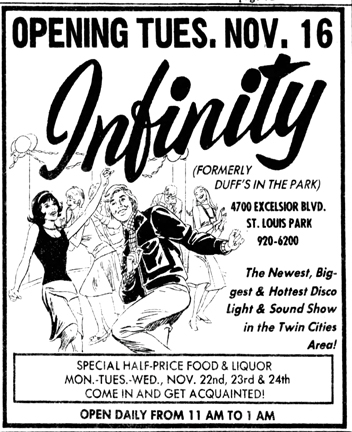
1976
For some reason it attracted a black crowd to a suburb that was still overwhelmingly white. Wilbur “Bill” Lindee, who was a working partner/manager at Lyle’s at Franklin and Hennepin, was hired to manage the bar. Bill kept the peace by prohibiting bikers from wearing their colors and anyone from wearing hats. Infinity was one of the first discos in the area.
Infinity went out of business in January 1979; an article about the final auction told of bidders wearing leather jackets, Stetson hats and expensive looking top coats. Everything went, including the black plastic walls.
CLASSIC MOTOR COMPANY
The final iteration of this classic Excelsior Blvd. bar was – the Classic. The Classic Motor Company, that is, decorated with actual classic cars. It opened in June 1979 by Richard Gold and his son Stephen I. Gold, who also owned the Gay ‘90’s downtown. The Golds were car collectors, and the bar featured antique cars on a revolving turntable, a different one each month. At least in the beginning, the car theme was everywhere – “autoburgers” were on the menu, and drinks were served in “cylinders.”
Although Stephen Gold claimed that this bar would not have the problems of George’s or Infinity, things seemed to have gotten pretty rowdy: on June 24, 1987, a memo from the building inspector to the police complained of “honking, hollering, car tires screeching, and fire crackers.”
In 1993 it was extensively remodeled into more of a sports bar and was known as the Classic Café and Bar. The manager at that time was John Canton (J.C.). Another owner was Big Al Cohen, who was reportedly responsible for the excellent food served at the Classic.
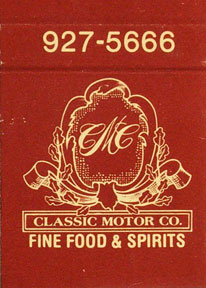
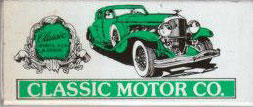
StarTribune article dated May 12, 1983:
Golds to test Duesenberg’s mettle against other vintage cars
Dick Gold, left, and his son, Stephen, displayed the father’s 1929 Duesenberg this week at Classic Motor Co., a St. Louis Park restaurant owned by the son, before hauling the car to California for the start of the first Great American Race May 21 in Anaheim, Calif. One hundred cars, none of them newer than 1942 vintage, will compete for the $235,000 purse while trying to reach Indianapolis on May 27 with an average speed as close as possible to 50 miles per hour. The Duesenberg, sponsored in part by James B. Beam Distilling Co., gets 6 miles per gallon of gas. Dick Gold, a classic-car buff for many years, will drive his car in the race, with Terry Nordstrom as navigator and Bruce Ross as mechanic. The four-door convertible was originally owned by A.K. Bourne, heir to the Singer sewing-machine fortune, who took delivery in 1930.
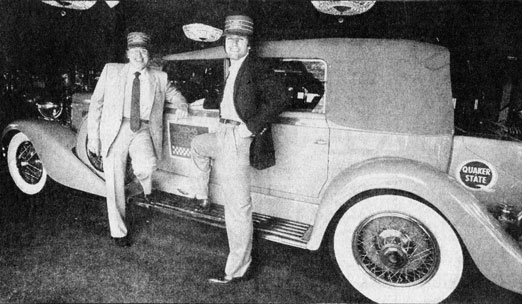
Minneapolis Tribune, May 12, 1983
The site eventually became the target of urban redevelopment, and the City of St. Louis Park purchased the land in 1999. Classic closed its doors on March 17, 2001, and the building was demolished to make way for Excelsior and Grand.
Randolph Edgar wrote that as late as 1902, this theaater was reached through a coveered alleyway at the corner of Nicollet Avenue and First Street.
The Parker House was a restaurant on the main street of Mendota.
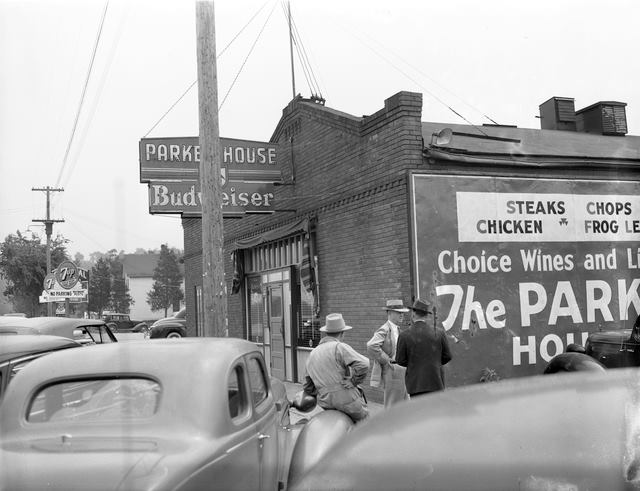
June 3, 1941. Photo courtesy Minnesota Historical Society
In 1943 it was purchased by “Genial” pianist Red Dougherty.
Diamond Jim’s employees hung out there, according to those in the know on Facebook.
In April 1944 an ad promised “Incomparable Foods – Your Favorite Liquors and ‘Something Different’ in Entertainment.” It was known for its frogs’ legs and popovers.
1963: Musical Entertainment.
1970: relaxing piano and organ music during dinner. Someone mentioned Bud at the organ.
The building is now Axel’s.
The Parkside Lounge was located at 1177 Clarence Street in St. Paul.
The ad below from 1969 indicates that the proprietor was Tom Ryan.
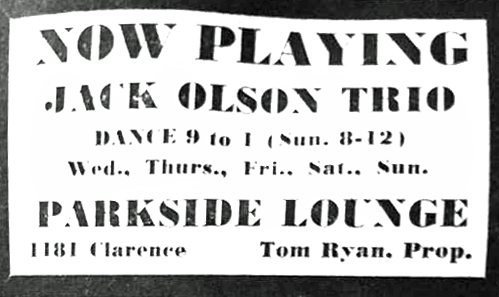
January 1969
Unfortunately, the St. Paul papers aren’t online. The last of very few mentions was on July 19, 1998, when Patrick Reusse profiled a 79-year-old member of the bar’s fast pitch softball team.
The area is now a shopping center, with a Cub grocery store. The Ramsey County Property Tax website does not provide the year the present building was built.
Paul’s Place started out as the Paul Bunyan Motel, which was located at 2965 N. Snelling (at Lydia) in Roseville.
THE PAUL BUNYAN MOTEL
I don’t know when the motel was built, but it was there in 1957 when operator Alf Robert Lee made the papers for threatening his wife with a gun. If there were no crime, there would be no information.
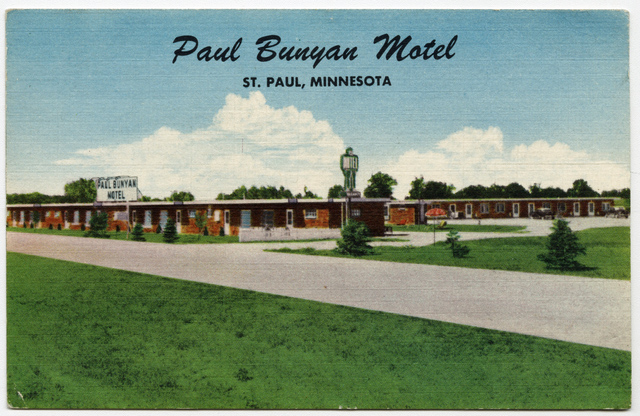
Postcard from the Minnesota Historical Society
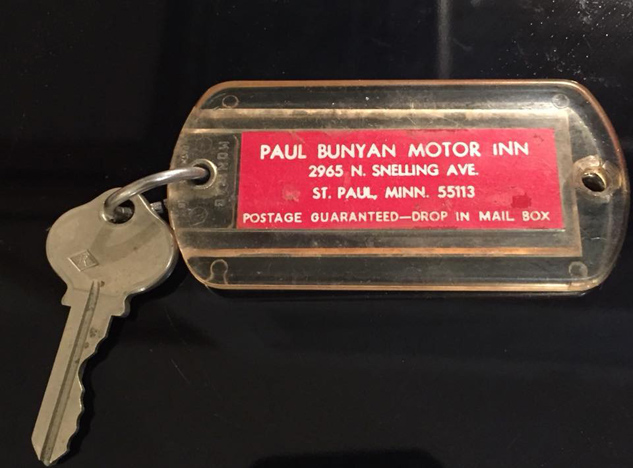
Image courtesy Jeff Falzone
PAUL’S PLACE
In 1967, Louis Johnson, an East St. Paul meat provider, converted a part of the motel into Paul’s Place, modeling his new private club on Hugh Hefner’s concept of serving excellent food by very attractive servers in revealing costumes. The club opened on June 19, 1967. Charter membership was $10, and by August 1967, membership was up to 4,500. In August 1967, Don Morrison of the Tribune paid a visit to Paul’s, which he said was “already jumping.” One of the reasons cited was that it was the only on-sale place in Roseville.
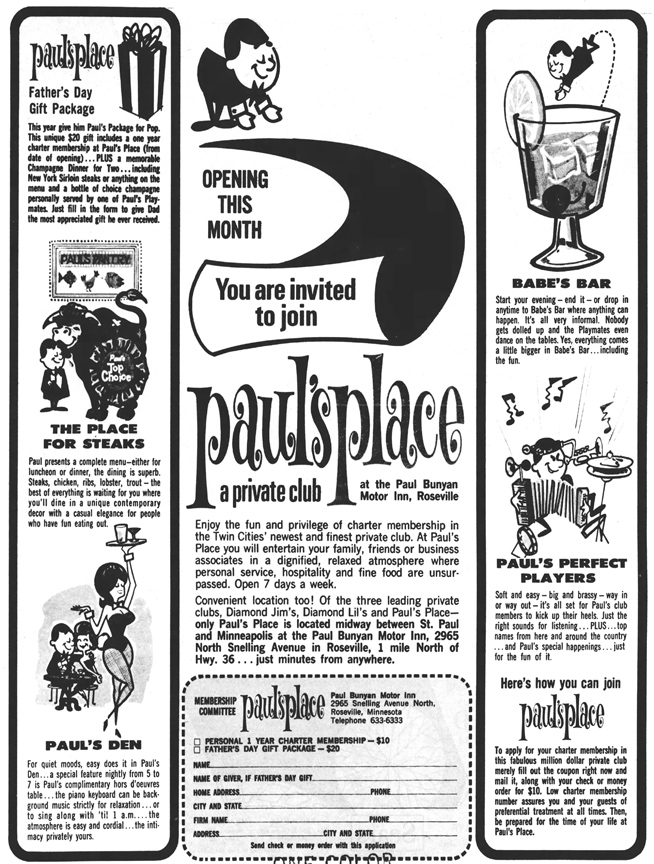
Minneapolis Tribune Picture Section, June 11, 1967
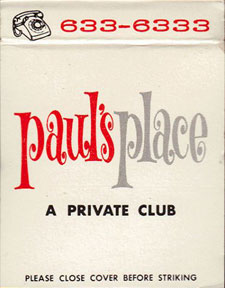
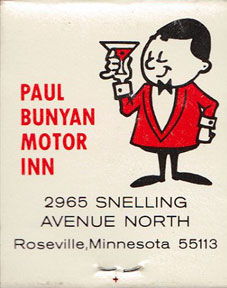
The ad below is undated but was probably from a magazine for visitors from 1967.
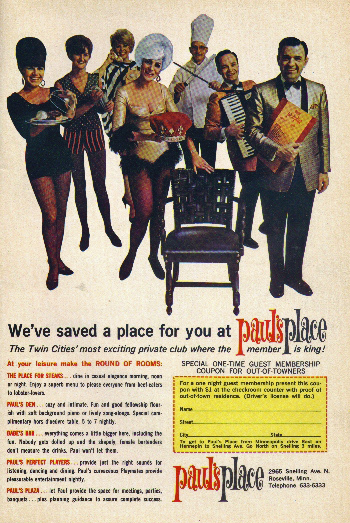
PAUL’S PLAYMATES
The hallmark of Paul’s Place was the plethora of Paul’s Playmates. As an ad in the April 27, 1967 issue of the Minneapolis Tribune described, they were “Attractive Girls, 21 – 29, to Serve cocktails, sing & dance. No previous experience necessary. Apply in person. NO PHONE CALLS.” The Playmates were clad in in what one person remembered as “bunny-type outfits. sans the ears and tails.” One guy described the waitresses as “Playboy Bunny wannabes,” but a former waitress responded, “I was never a bunny wannabe however, it was a job is all.” Another comment was, “If you worked there you were cute. All the girls were.” One of the best comments was:
I worked my way up there from dishwasher to stock boy and breakfast cook in 1977. Louie Johnson owned the place and Danny his son ran the night ops. All the waitresses ran around in skimpy little outfits with fishnet stockings. This was a teenage boy’s dream job.
VENUES AT PAUL’S PLACE
The ads above spell out the initial names of the various rooms at Paul’s.
THE PLACE FOR STEAKS: Elegant dining – the chef was Joe Yankovich, formerly at the St. Paul Hotel and the Hillcrest Country Club. At first the show in the main dining room was a large a dance orchestra complete with some of the Playmates taking turns on a swing suspended from the ceiling. Sometime between September 1967 and January 1968, OSHA regulations regarding employee safety required Johnson to eliminate the swing which was mounted near where the orchestra was seated. The orchestra proved expensive and was soon replaced by the Betty Rydell Trio.
In August 1967, Don Morrison found that the main dining room was “handsomely proportioned and quietly tasteful in decor.”
Bob Terry’s trio makes nice sounds and is assisted by a succession of cocktail waitresses who either take up a microphone to sing surprisingly well, or climb up on tables to do a quick Charleston or whatever.
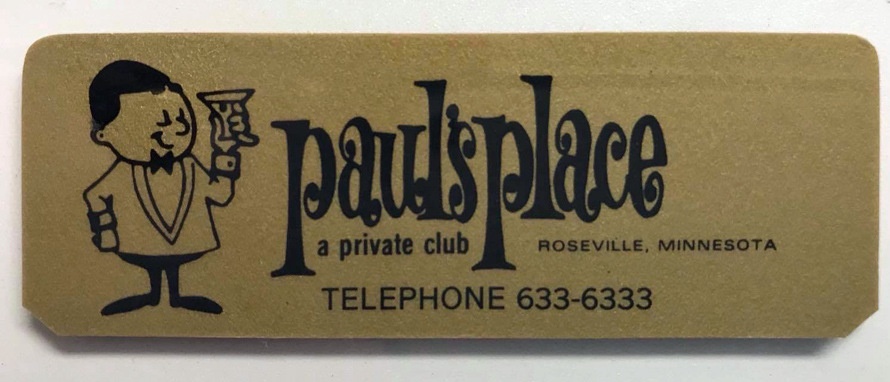
PAUL’S DEN: The ad read, “For quiet moods, easy does it in Paul’s den … the piano keyboard can be background music strictly for relaxation … or to sing along with ’til 1 am … The atmosphere is easy and cordial … the intimacy privately yours.” Initial entertainment was provided by Lannie Dee.
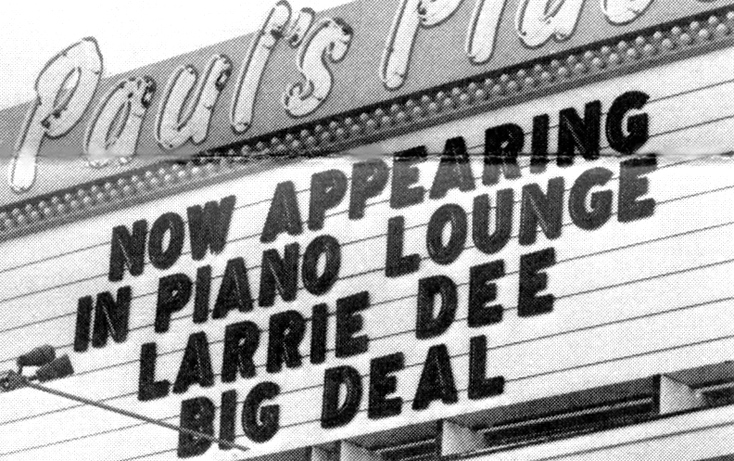
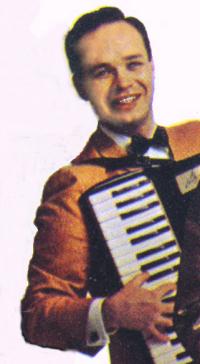
Larrie Dee
Don Morrison found the piano lounge “small and restful, where an organist was burbling unobtrusively and waitresses, again, joined in for ad lib entertainment.” (Tribune, August 1967)
This room may have become what someone remembered as the Rib Joint/Peanut Bar, on the south end of the complex, upstairs.
BABE’ S BAR: “Start your evening – end it – or drop in anytime to Babe’s Bar where anything can happen. It’s all very informal. Nobody gets dolled up and the Playmates even dance on the tables. Yes, everything come a little bigger in Babe’s Bar … including the fun.” The color ad seems to say, “Shapely female bartenders don’t measure the drinks. Paul won’t let them.” One comment was, “My folks were members and I recall that when you ordered a drink, the server would ask if you wanted “regular” size or “decent” sized. The decent size was huge!”
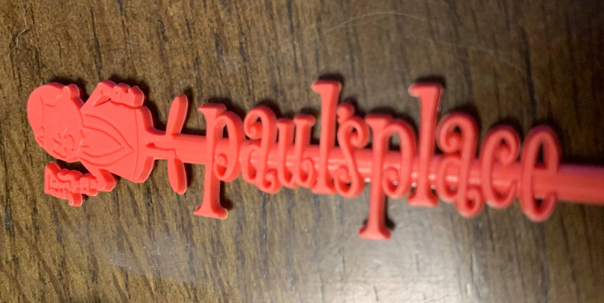
PAUL’S PERFECT PLAYERS: “Soft and easy – big and brassy – way in or way out – it’s all set for Paul’s club members to kick up their heels. Just the right sounds for listening … PLUS … top names from here and around the country … and Paul’s special happenings …. just for the fun of it.” My understanding is that this is the room that changed with the times, providing entertainment for young people.
This may be the venue remembered as a downstairs “psychedelic room.”
McCAULEY AT PAUL BUNYAN
The photo below was taken by Mike Barich on August 23, 1969. Mike was the staff photographer for the Insider magazine, but there are no clues in that week’s issue as to who McCauley is. It is certainly disc jockey Tac Hammer on the left and DJ Jimmy Reed on the right – at the time they were both working for KRSI radio.
Tim Campbell suggested that McCauley may be Tony Macaulay, a British songwriter who wrote or co-wrote such hits as “Baby Now That I’ve Found You” and “Build Me Up Buttercup,” recorded by The Foundations; “(Last Night) I Didn’t Get to Sleep at All,” by the Fifth Dimension; “Love Grows (Where My Rosemary Goes),” by Edison Lighthouse; and “Don’t Give Up on Us,” recorded by David Soul. They’re looking at an album – what could it be? At least we have a peek inside Paul’s Place!
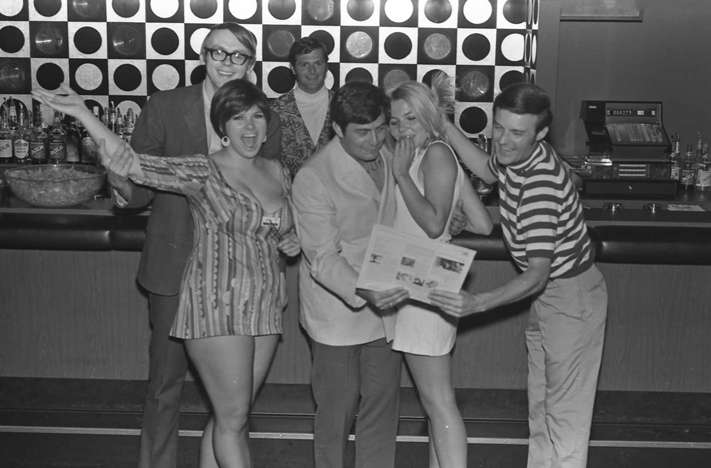
Photo copyright Mike Barich, St. Paul
It was apparently this venue that became known for its huge beer selection. One comment was, “It was one of the first places in the Twin Cities to carry an extensive selection of imported beer. In the 1970s they had 300+ beers on their list.”
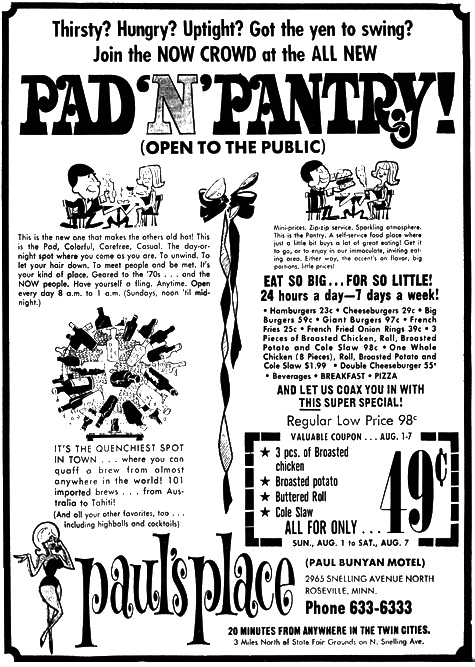
Early hip venue, Pad ‘N’ Pantry. Ad from Minneapolis Tribune, August 1, 1971.
This venue probably became a disco in the ’70s and ’80s.
PAUL’S PLAZA: for weddings, parties, and banquets.
THE END OF PAUL’S PLACE
Unclear when Paul’s Place closed, but the last crime report was on August 9, 1990.
A brief blurb on November 11, 1993, in the Minneapolis Star Tribune tells us that Paul’s Place had been torn down to make way for senior housing and a new motel.
There is a college administration building on the corner now with a senior complex behind it. (Eagle Crest Assisted Living) 2945 Lincoln Drive.
SOURCES
Thanks to all the commenters on Facebook for your recollections of Paul’s Place!
http://www.larriedee.net/PaulsPlace.html
Minneapolis Tribune, April 27, 1967 (wantad)
Minneapolis Star, June 14, 1967 (Don Morrison’s column)
Minneapolis Tribune, June 27, 1967 (Will Jones’s column)
Minneapolis Star, August 14, 1967 (Don Morrison’s column)
Peabody’s was in Inver Grove Heights – the former Schleif’s Little City, which then became Thumper’s South. By now the building had an actual address: 7884 Courthouse Blvd.
The building had been there since at least 1935. The 20,000 sq. ft. dance floor was made of maple and had a capacity of 1,749.
Peabody’s opened on November 16 and 17, 1979, with performances by Heartsfield. Richard “Eli” Ball was to book the bands.
Randall Quade says that:
It went on–due to the popularity of the ‘Urban Cowboy’ movie–to become a huge country and western bar called “Peabody’s Saloon and Music Hall.” I used to play there in the mid-’80s with a band called Saddletramp. The bar featured a huge dance floor and booked national, regional, and local acts.
The bar also had a mechanical bull, called El Toro, which cost $2 a try to stay on, just like “Urban Cowboy.”
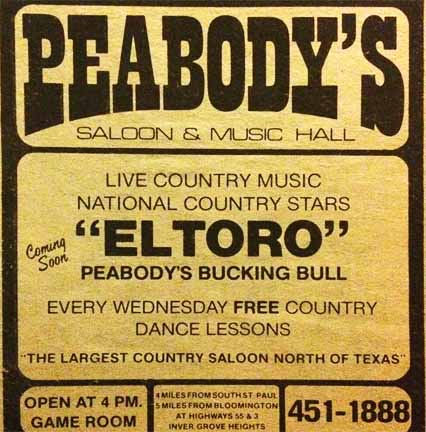
Image courtesy Sandra Kenyon
Some of the acts people remember seeing at Peabodys are:
- Asleep at the Wheel
- Steve Goodman (cancelled?)
- Rory Gallagher
- Ozark Mountain Daredevils
- Leon Russell – December 16, 1979 – Cancelled
- Outlaws
- Molly Hatchet
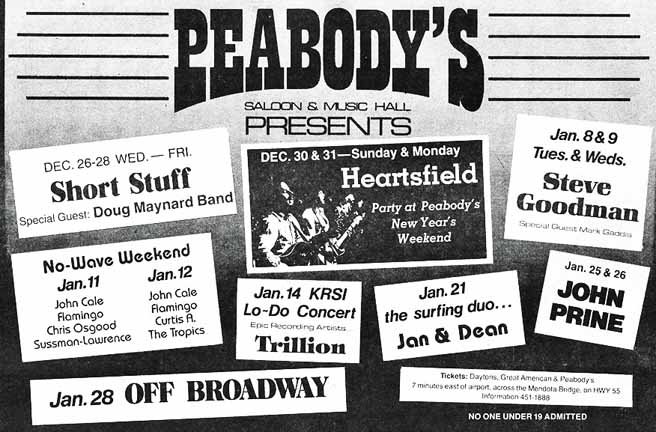
December 1979 Image courtesy Errol Joki
DOWN IN FLAMES
Peabody’s burned to the ground in the early morning of February 13, 1984. The fire was believed to have started in a liquor storage area. 50 firefighters arrived at about 7:30 am, and most were gone by 3 pm.
Incredibly, there was not a fire hydrant within a mile of the bar, requiring water tanker trucks to be brought in from Inver Grove Heights, Mendota Heights, Eagan, Rosemount, and Hastings.
Inver Grove Heights Fire Chief Dale Beckmann:
It took us about 45 minutes to get a good water shuttle going with the trucks coming back and forth. I think if we’d had a hydrant around here, we may have been able to save the west end of the building. The place was built just like an old-fashioned barn, big open ceilings, big wood joists. And that’s why she really took off. When we got here, the flames were jumping about 100 feet in the air. Really a sight. The heat within the building must have been just tremendous because the fire had so much room, so much space. In a few days we’ll have a good idea of how It happened.
(Minneapolis Star and Tribune, February 14, 1984)
The Manager of Peabody’s was Dennis “Denny” Sazenski, and the owner, Tom Davis, was out of town.
Harry on Facebook remembered, “When it burned down, the only thing you could see left was the burnt-up bull.”
Randall Quade reported that “No remnants of the bar exist and the site is covered with a new commercial development.”
The Peacock Alley Bar and Cafe was at 214-220 N. Fifth Street, Minneapolis. In 1965 the bar was purchased by Mr. and Mrs. Harvey Jones. The deed and license had to be in her name because she was white and he was black. In a December 1967 article in the Minneapolis Star it was described as “a long, narrow, high-ceilinged room that is dark even during the noontime rush.” Mr. and Mrs. Jones wanted to move the business 1 1/2 blocks away to 325 First Ave. No., but the move was opposed by neighbors. “We’d like to run a
nice Negro bar – be able to bring in name entertainers from time to time,” said Mrs. Jones. “I wish you could see some of the places Harvey and I have looked at in Chicago, in some of the Negro areas there. But here – well, there aren’t even many nice places where whites can go to meet their friends and have a good time without spending a lot of money.”
Al Senter bought the bar in 1972, in the face of problems with fights and shootings after which witnesses would not testify. Until January 1972 the manager was Charles Bryant. That July a group of 20 to 25 black youths, one reportedly carrying a high-powered rifle, entered the premises and told customers that the bar “had beer be closed down by 8 o’clock.” The bar did not close, but most of the customers left and did not return. The group of youths closed down at least two other bars with bad reputations that night as
well. Senter discontinued the live music and disk jockey and even took out the pool table to curb the rowdiness. In November 1972 Senter reported that there had been only one
shooting since he began in January and that incidents were on the way down.
Other memories are that at one time the club was owned by Imogene “Fair Lady” Hargrove, who had been a band singer in the 1960s. There was apparently also a sign at the door that said “Your Pistol is Not Welcome Here.”
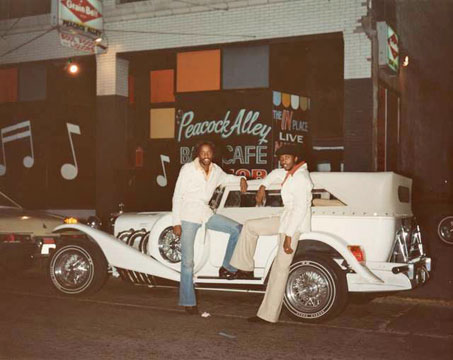
Photo by Charles Chambliss, courtesy Minnesota Historical Society
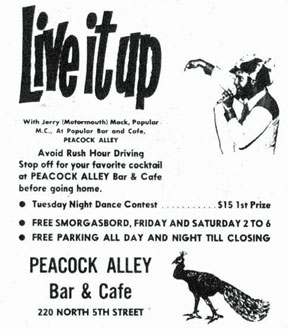
Please see the Blue Horse.
The Peacock Tavern was a jazz venue located at 631 Stinson Blvd. in Northeast Minneapolis. The first ad found in the Star Tribunewas dated November 29, 1964 – the performers that night were the Hall Brothers.
The only deviation from the jazz genre seems to have happened in the spring of 1965, when owner John Rimarcik succumbed to the temptation of rock ‘n’ roll and brought the Nobles in for some teen dances.
The last reference I found for the Peacock Tavern was dated August 17, 1979. According to county property records, the building was replaced in 2001.
Will post ads soon.
Peggy’s after hours club, Olson Memorial Highway
The Pence Opera House was built by John Wesley Pence, the President of the City Bank of Minneapolis, originally from Ohio. The Opera House was located at 126-128 Hennepin Ave. at Second Street in Minneapolis.
Its original name was planned as the Pence Music Hall. It got grander as things progressed, and on June 19, 1867, Mr. Pence replaced the Music Hall sign with Opera House. The theater was located on the third floor of the building and contained a balcony – an innovation at that time. Its architect was Abraham M. Radcliffe.
The three-story building housed shops on its first floor, offices on its second, a billiard parlor in the basement, and the theater on the third.
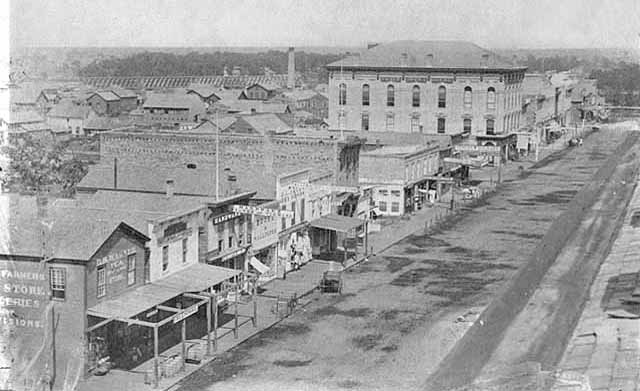
Hennepin Avenue, 1867. Pence in upper right. Photo MHS
The Pence opened on June 21, 1867, with a joint concert of the Minneapolis Musical Union and the St. Paul Musical Society. It had a seating capacity of 700.
Its first dramatic production was Sheridan Knowles’ play, “The Hunchback,” starring Rachel Johnson, on June 24, 1867. The performance was attended by Governor William Marshall and Senator Alexander Ramsey.
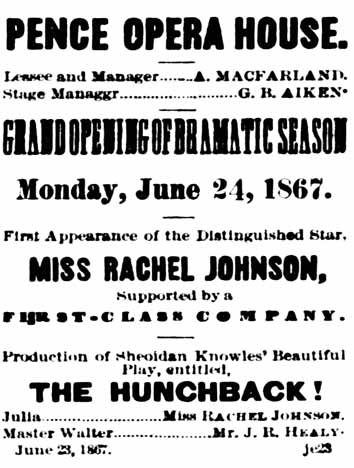
Minneapolis Daily Tribune, Sunday, June 23, 1867
One writer posits that the Pence was overshadowed by the Academy of Music, which was built in 1871 at the corner of Washington and Hennepin Avenues. That building closed in 1883, but was replaced by another, grander Opera House, and so on.
Sometime in 1879, the Metropolitan Theater Company took residence in the Pence Opera House, and the theater itself became known as the Metropolitan Theater. Also in 1879, the theater was remodeled and increased its capacity to 900.
In September 1880 the Criterion Theater stock company replaced the Metropolitan Theater Company, which had some to a “somewhat inglorious end.” The Criterion ended their stay in January 1881.
On January 24, 1881, the Pence Opera House re-opened with a new stock company. It apparently operated until mid-May 1885, with a hiatus until another re-opening in January 1886.
Pence refers to a panic caused by an accident to a trapeze performer and that the theater closed its doors in 1888.
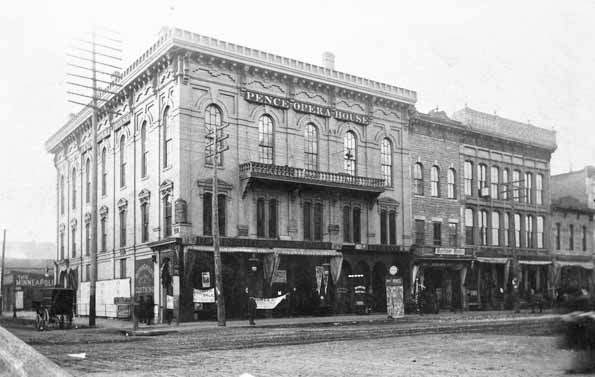
1882 – Minnesota Historical Society
In October 1889, receipts were so poor that the manager dismissed the company for the season. It re-opened on December 17, 1889, to a packed house to see a novelty act. Further performances appeared to be sporatic.
In June 1890 the theater was leased by Edward Hilton, who began renovations for the fall season. The Pence opened as a burlesque and vaudeville house in the fall of 1890. By January 1891 Hilton was discouraged, and talking to Pence, who still owned the building, about erecting a more modern structure that faced Hennepin Avenue and was on the first floor. Vaudeville performances struggled on until about May 1892. In April 1894 it had become an Oriental Museum – only men had to pay the admission of 10 cents.
The last performance was a benefit given for the manager, Edward P. Hilton, on June 12, 1894.
The 1894 season was to begin on October 1 with a vaudeville company on board, but the performance and the season never happened. Pence died in late May 1893 and he was buried at Lakewood Cemetery. Having no will, his fortune of approximately $1 million was divided between three brothers and two sisters, none of whom lived in Minnesota. The paper reported that his estate was contemplating tearing down the building. The doors were locked and the theater went dark.
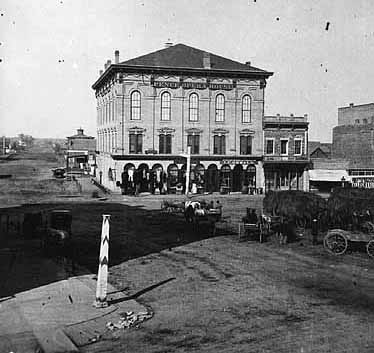
Pence 1896. Photo Minnesota Historical Society
THE FLOUR CITY CLUB
On June 4, 1901, police raided the “Twin City Club and Employment Bureau” on the second floor of the old Pence building. This club was made up of black men and women, some of whom lived there permanently. The entire detective detail hauled away 25 men, gambling paraphernalia, and Henry Mosely, the “proprietory,” who was fined $100 for selling liquor without a license. Seventeen men paid fines, three went to the workhouse, and the City netted $260.
In July 1905 another gambling arrest tells us that Edward Stewart was the proprietor.
In April 1911 the cops raided the club again – now called the Flour City Club – for gambling. Ed Stewart was still the proprietor.
Finally in November 1911, police conducted the last raid, arresting Stewart for keeping a gambling house, and 30 others for being found in a disorderly house. Stewart complained that he was being discriminated against because of a “sudden spasm of righteousness. It was well known that I run a small crap game there, and I was told there would be nothing said about it. Only colored people patronized my club and they must have a place of amusement.” Stewart was right, in that the police were cracking down in an attempt to find out if there was public bribery going on.
In 1906 the City proposed the site for a new Post Office but it was not chosen.
An article from March 15, 1908, gives the status of the old theater in flowery language:
For 16 years it has been dark – a dumping place for rubbish. Years ago its footlights faded out altogether. The violins in the pit trembled over the last finale. Actors and audience passed down the old humanity market staircase, and its proud history passed into the bygone.
UNION CITY MISSION
In 1912 the Union City Mission began to raise funds to buy the Pence building, with the intention of erecting a seven-story social services building and “workingman’s hotel.” The planners hoped to house 400-500 men in 185 rooms. The building was purchased by the Mission in 1913.
In 1915 it was determined that the old building would have to do until a new one could be built. The War in Europe was making it difficult to build. Plans had now grown to a 12-story building. The old one was was given a new coat of yellow paint, a new roof, new plumbing, facade, and the gallery railing was to be made into part of the Altar. The Tribune (April 18, 1915) described the mess that had been made of the old theater, and how small it had been compared to contemporary venues.
In 1923 the building was given a new facade and the auditorium enlarged.
On January 27, 1935, the Minneapolis Tribune described the inside of the theater:
Around the dome were pictured eight angel children dancing, with figures of the four seasons nearby. Beside the stage on either side, were Washington holding a sword in one hand and the Constitution in the other, and Lincoln with a scroll. Over the gallery in the rear was a portrait of President Andrew Jackson, while over the stage was seen a bust of Shakespeare, surrounded by a wreath of leaves supported by two female figures with angel appendages, one on each side. Over the boxes were Tragedy and Comedy, and above the arch was the American eagle, standing on a shield, while from his mouth flowed a streamer with the words, J.W. Pence, dedicated June, 1867.
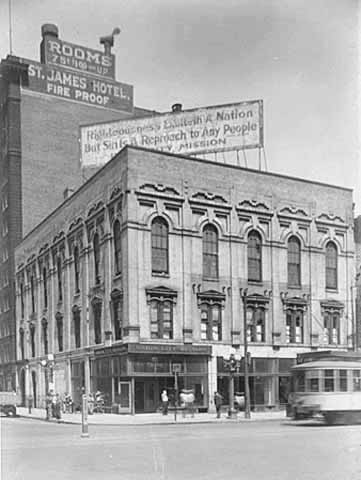
Union City Mission, 1936. Photo MHS
In the April 8, 1952, Minneapolis Star, photos were shown of the inside of the building as the Union Mission prepared it for renovations. A new Mission, incorporating parts of the theater and taking the place of some demolished buildings, was dedicated in November 1953.
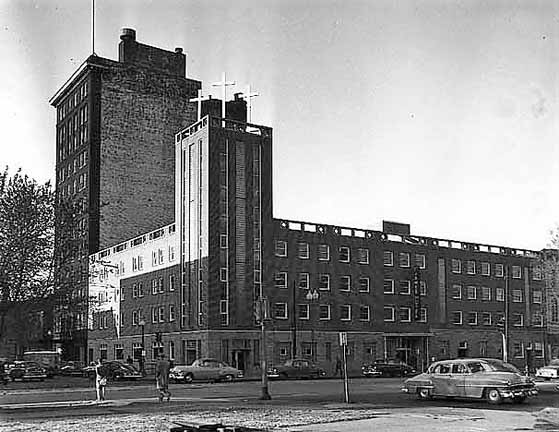
Union City Mission, November 7, 1953. Photo MHS
The Union City Mission was one of the many buildings demolished during the clearance of the Gateway. It was demolished in late August 1963.
Also see: Playhouse for Pioneers: The Story of the Pence Opera House by Donald Z. Woods
This was one of the names used at the Chisago City Community Center.
This page covers three related venues:
- Ye Tavern Inn
- The Pershing Inn
- The New Pershing Inn
This building was always described as on Superior Blvd., a mile from the City Limits. The Turf Club was also a mile from the border on Highway 55, and that address was 4900, so presumably the Pershing was located at 4900 Wayzata Blvd. in Golden Valley. This would be in the NE quadrant of the Highway 394/100 intersection. The site is probably under the freeway or on an on-ramp today.
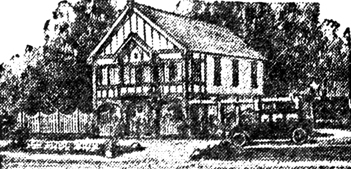
Minneapolis Daily Star, April 24, 1926
YE TAVERN INN
The first mention found of the site was in 1921, in a column by “Pollyanna” in the Minneapolis Sunday Tribune. An early gossip column, perhaps? She describes it as a “new pleasure house,” just a 15 minute drive from downtown. She lauds the excellent music, dancing, entertainment, and food. “And besides all this, There is that air of refinement and good taste which will put you at your ease.” And although Polly didn’t call it that, it had valet parking! (July 3, 1921)
In actuality it was probably an early suburban speakeasy, opening in the second year of Prohibition under the wary eye of the county sheriff.
On February 7, 1922, a “Daring Bandit Raid” took place at the Tavern, when nine young bandits, directed by a gray haired leader with two guns, held up the 75 patrons. While the older man covered the group with his guns, his helpers relieved them of diamond rings, necklaces, breast pins, small jewelry, and about $800 in cash. Then they ripped the phone from the wall, “slugged the cook and two waiters, and dashed away in a touring car without lights.” (Minneapolis Journal, May 17, 1926)
By 1924, things may have gotten out of hand. The ad below tells us that the management has changed for the better, with upstanding citizen William A. Ryan as proprietor. Clearly they wanted to throw the bums and drunks out and run a high-class speak.
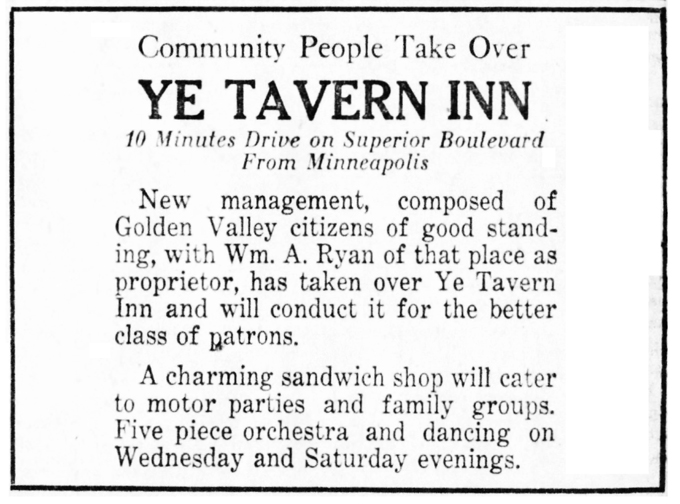
Minneapolis Tribune, August 13, 1924
The following ad reiterated that only the better class of people were welcome:
Ye Tavern Inn, Superior Blvd. – The place you always wanted to go to eat. Now open. Only the better class of people invited. Dancing and good music Wednesdays and Saturdays. (Minneapolis Tribune, August 15, 1924)
PERSHING INN
By 1925 the place had changed its name to the Pershing Inn, as evidenced by a report that it had lost its roof and porch as a result of the tornado/cyclone of that year. It closed June 2 and 3 for repairs. (Minneapolis Daily Star, June 3, 1925)
On January 1, 1926, in the middle of New Year’s Eve celebrations, a fire started on the roof and the party was over when firemen from Minneapolis “invaded the building to fight the blaze.” There was only slight damage. (Minneapolis Tribune, January 2, 1926)
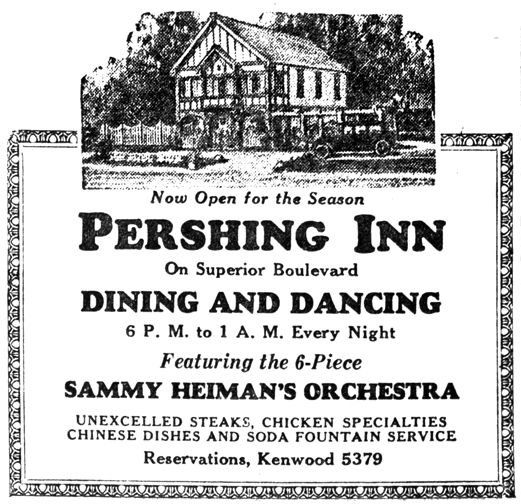
Minneapolis Tribune, April 17, 1926
THE PERSHING PERISHES
The Pershing building burned to the ground on Sunday afternoon, May 16, 1926. The fire broke out in the kitchen, and although the St. Louis Park fire department arrived soon after, lack of water made it impossible to fight. The fire spread quickly through the two-story frame building. By the time the Minneapolis fire department arrived with chemical equipment, the building was a “mass of flames.”
In those days when entertainment was at a premium, fires brought spectators from miles around, further foiling the efforts to douse the flames. People driving to “the lakes” (west to Minnetonka? East to Minneapolis?) stopped to watch, lining the road with cars. Motorists and firemen formed a bucket brigade to save adjoining buildings. Several patrons were in the Inn at the time the flames broke out, but no one was injured. (Minneapolis Tribune, May 17, 1926)
The next day, all that remained was a lone chimney was all that was left. It was revealed that the Inn had been managed by Artis Boettcher and Benjamin Blindman. Damage was estimated at $15,000. (Minneapolis Journal, May 17, 1926) The company that owned the business was declared bankrupt on June 18, 1926.
THE NEW PERSHING INN
Although quite a distance from the original Pershing, a “New Pershing Inn” opened in White Bear Lake on December 3, 1927. It is unclear whether this venue is related to the Pershing Inn in Golden Valley. It was in the building better know as the Plantation Nite Club, and only lasted for a month or so.
In 1940, 324 Marquette was the site of the Persian Bar (not the Persian Palms), owned by Charles A. McCutchan and Michael “Mitch” Code. That March it was under indictment for maintaining gambling devices.
Code died in 1946, and that year the site became the first location of Herb’s.
The Persian Palms Nite Club was located at 109-111 Washington Ave. So., deep into Skid Row.
THE BUILDING
Minneapolis permit records don’t show when the building was built, but it was there as of 1891. It was a hotel with a store on the ground floor at that time. By 1898 the ground floor was a saloon, and in 1905 there was also a pawn shop on the premises. During Prohibition there are notes for a cafe, barber shop, and pool room; it continues to say cafe until June 1936 when it changes to “beer parlor.”
Much of the information for this page comes from an article in the Minneapolis Tribune written by Charles Hanna on August 27, 1961, just before the Persian Palms was to meet the wrecking ball. I will annotate these passages as “Hanna.”
The bar was also rife with “B-Girls” who implored customers to buy them drinks.
It may have been the most popular of the many, many bars in the Skid Row sector, no doubt because of its entertainment.
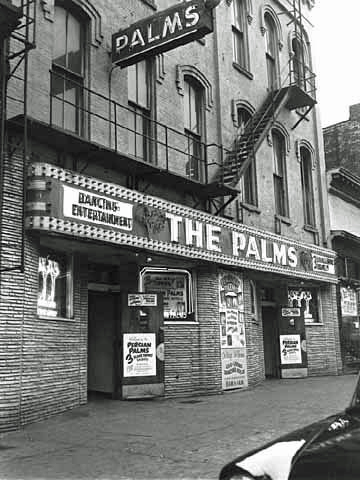
Photo courtesy Hennepin County Library
DESCRIPTION
Hanna provides these insights into what the Persian Palms looked and felt like:
The sign featured red, yellow, and green bulbs.
Bar stools stood at the two bars in the club’s front room, where exotic dancers sat with their short skirts hoisted above their knees.
There was a big tin sign that hung over the rear of the building that read “Welcome to the Persian Palms … Live Music and Entertainment.” A painted palm tree on the sign shaded a dancing couple dressed in a tuxedo and evening gown, uncommon attire in the club even in its heyday.
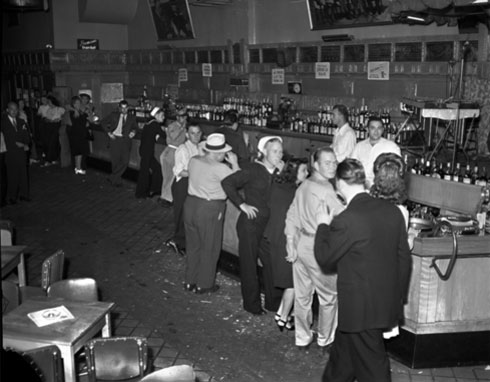
Photo from Hennepin County Library Special Collections
Visitor magazine provided this description of the wonders of the club in 1960:
The biggest bevy of beautiful girls in town, providing voluptuous and exotic type entertainment. The Palms always provide a lot of easy on the eyes, but hard on the heart performances. Beautiful dolls, gorgeous gals, Western music and song all day long. The most talked of spot in the Twin Cities. Ten gorgeous cuties make this the Lido of Minneapolis. Minneapolis’ answer to a Parisian Holiday. Why go to Paris when that certain famous something Paris offers is right here in town. Enjoy the best drinks during the best show anywhere. Not a penny extra for a million dollar production. No cover or minimum.
BEER TAVERN
In January 1936, Mrs. Jule Sund Kadrie had a 3.2 beer license at the Persian Palms, and applied for a liquor license. The City Council took the request under advisement because her husband had been arrested twice for gambling. Her request was denied. In March 1936 she applied for a dance hall license, which was approved in April 1936.
On April 1, 1936, Mrs. Kadrie was charged with allowing a 17-year-old to dance in the beer parlor. She was acquitted.
On January 7, 1939, Mrs. Kadrie was arrested in a police sweep of bars looking for gambling equipment. She was found with two 14 boards, a spin-O game, and a dice game called Bing. Citing the Bing game as “particularly treacherous,” the judge fined Mr. Kadrie $100 for keeping a gambling house. (Minneapolis Star, January 20, 1939)
Gambling again was the charge when Mrs. Kadrie was summoned to court on January 9, 1940. The judge acknowledged that he had heard so much about the place that he was bound to be prejudiced, so he continued the case until his term ended. His successor assessed the fine of $75. (Minneapolis Star, February 10, 1940)
Riots, stabbings, thefts, and other mayhem were reported at the tavern.
Mrs. Kadrie’s 3.2 beer license was revoked on April 1, 1940.
HARRY SMULL
The bar was back in business by January 1941, as we learn in a report of a stabbing, natch. At about the same time, the bar obtained a liquor license, transferred from 312 S. Fourth Street. (Hanna) It is unclear who was operating the bar or who owned the liquor license.
It was only in October 1942 that the bar’s ownership was listed in the paper as the Minnesota Tavern Corp., Harry Smull, President. Smull, at various times, owned several other bars, including the Little Dandy, Old Bowery, Bowery, Frolics, and the Saddle Bar.
On December 29, 1942, fire routed 55 customers and destroyed the bar. Repairs were made in February and March 1943.
ENTERTAINMENT
Ads for shows only started in earnest in 1948. Below is just a sample to get a taste of the entertainment that could be had at the Persian Palms.
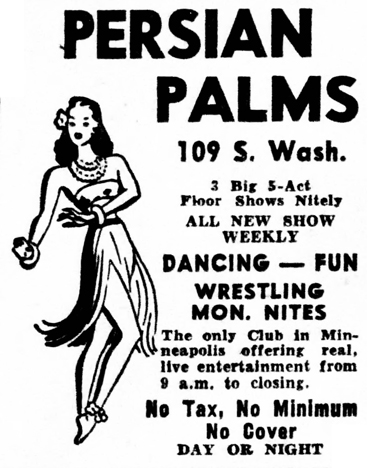
Minneapolis Star, June 9, 1949
THE BEEF TRUST CHORUS
How about an act featuring five ladies each over 300 pounds? The concept goes back to the turn of the century.
And there were lots of shows featuring female impersonators – in 1949!? Dressing in drag for a show was okay, but if you were caught in a dress in a gay bar you were hauled off to jail.
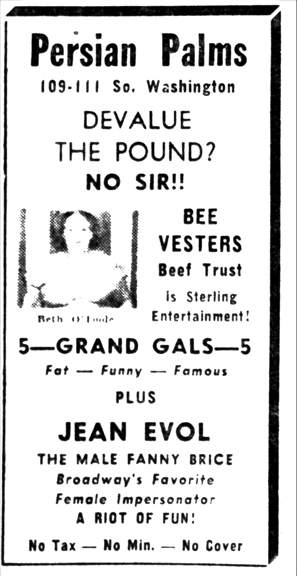
Minneapolis Star, September 22, 1949
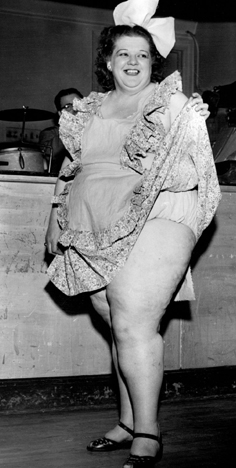
Violet Morton, Captain of the Beef Trust, profiled by Will Jones on January 21, 1951
DIVINA IN A TANK
And there was Divina, the underwater stripper. The ad is hard to read; it says,
Curves alive with the poetry of artistic and unrestrained motion … sheer lovliness in bodily rhythm … AN EYEPOPPING SUBMARINE DISPLAY OF SINUOUS, ARTISTIC ACTION Underwater, on stage, in person.
Note the two uses of the word “artistic.”
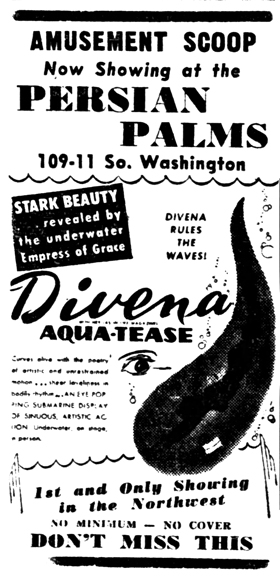
Minneapolis Star, September 22, 1950
Around that time, the famous New York photographer known as Weegee was in town and took the photo below of a man in front of the Palms. Devina is being advertised in the window.
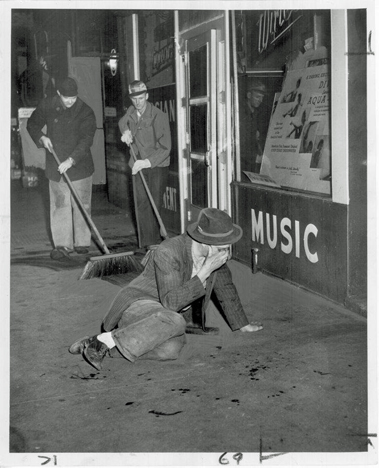
1950 Photo courtesy Hennepin County Libraries Special Collections
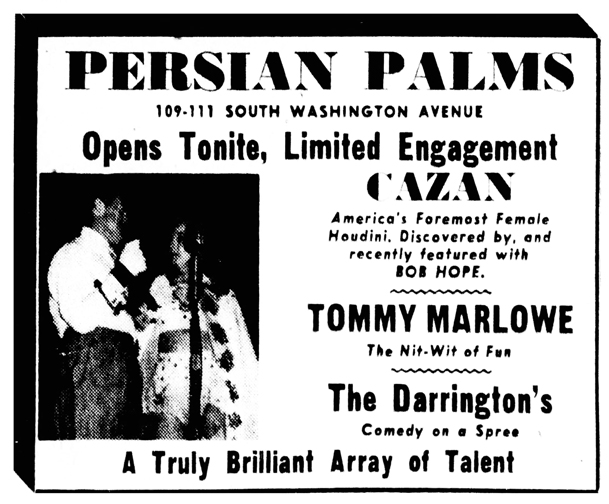
Minneapolis Star, June 15, 1951
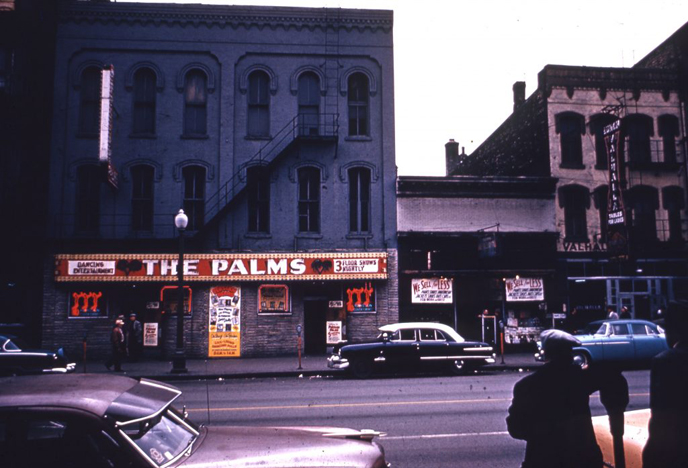
@1955 Photo courtesy Hennepin History Museum
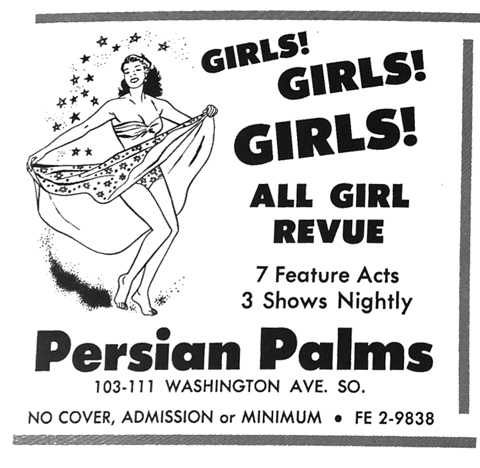
1957 Ad courtesy Mark Youngblood
THE MURDER OF BARBARA JEAN LACOUNT
Jeff Neuberger tells this tale of murder of a stripper/B-Girl at the Persian Palms:
On July 17, 1958, 24-year-old Barbara Jean “Bobbie” LaCount had finished her second show at the Persian Palms. Ms. LaCount, billed as The Black Cat, would dance and undress to the music of a three-piece combo as a mostly male crowd sat around small tables nursing 50 cent bottles of beer and watching the show. After her show Ms LaCount went into the bar room of the Palms, as part of her job was to have drinks with customers.
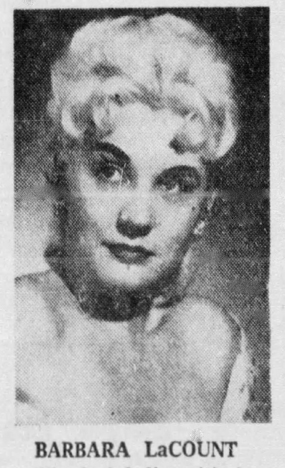
Minneapolis Tribune, July 27, 1958
At about 11:00 pm she sat on a bar stool drinking with a customer and another dancer named Siri. At this time Stanley LaCount, Bobbie’s estranged husband, entered the bar and came up behind her. As she turned he drew a .38 caliber pistol from his pocket and shot her once in the back. She gripped the side of the bar for support and gasped “Somebody help me! Siri, he’s killing me.” Then she said “Stan, no Stan!”
Miss LaCount slid to the cigarette-covered floor of the bar and Stan LaCount fired five more times into her body. Stanley LaCount then dropped the now empty pistol, sat on a bar stool, smiled, lit a cigarette and waited for police to arrive. He was arrested by Minneapolis Police and would be charged with 1st degree murder. The Minneapolis Star reported that he was despondent over an impending divorce that his wife had filed, charging that he had often beat her.
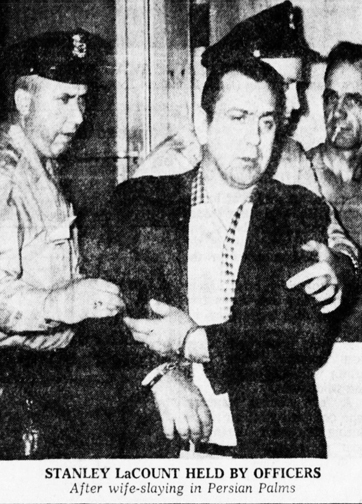
Minneapolis Star, July 18, 1958
LaCount, a saxophone player who had met his estranged wife playing in strip clubs, gave the reason for the shooting as “because she was the only woman I ever loved and she didn’t want to have anything to do with me.” He plead guilty to 2nd degree murder and was sentenced to life in prison, as he already had an extensive criminal record and was on parole at the time. The wonders of the Minnesota parole system would find him out before 1975 as he married his fourth wife in Robbinsdale that year. LaCount would marry once more before his death in 1982 in Texas from natural causes. Bobbie LaCount was buried in her hometown of Denver.
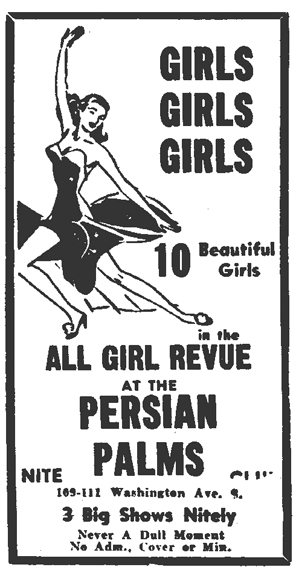
1958 Ad from the Minnesota Daily, courtesy Robb Henry
THE MURDER OF HAROLD FULLER
Jack Record had just hit Minneapolis the day of September 2, 1959. By that night he had stabbed Harold E. Fuller to death in front of the Persian Palms and was in jail. “And I’d do it again,” he told Minneapolis police.
Record was a 49-year-old transient with a long police record who had been panhandling on Washington Ave. Fuller was a 28-year-old part time bartender at the Idle Hours tavern in St. Paul, out with his girl June. Fuller had given Record a quarter the first time they met, but when Fuller moved on to another bar, Record insisted that Fuller made a derogatory comment about his race (he was black) and took it in his mind to stab him. June was equally insistent that no words were exchanged.
Fuller, aided by June, staggered into the Persian Palms, and died on the floor. Meanwhile, two bartenders and a customer took off after Record and captured him, surrendering him to the police. Record was tried and sentenced to life in prison.
Pictured below is the deceased Mr. Fuller under the sheet (they published pictures like this in those days), and June in distress next to the policeman.
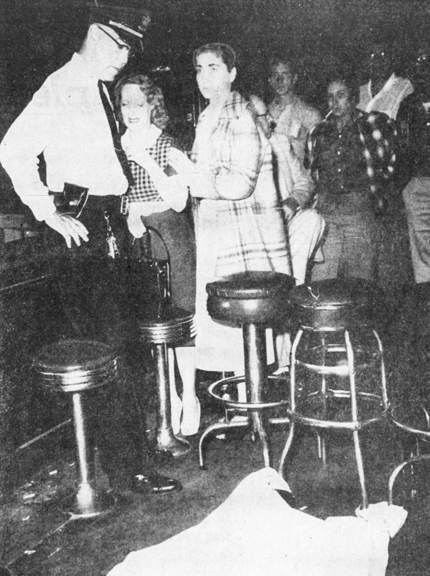
Minneapolis Tribune, September 3, 1959. Photo by John Croft
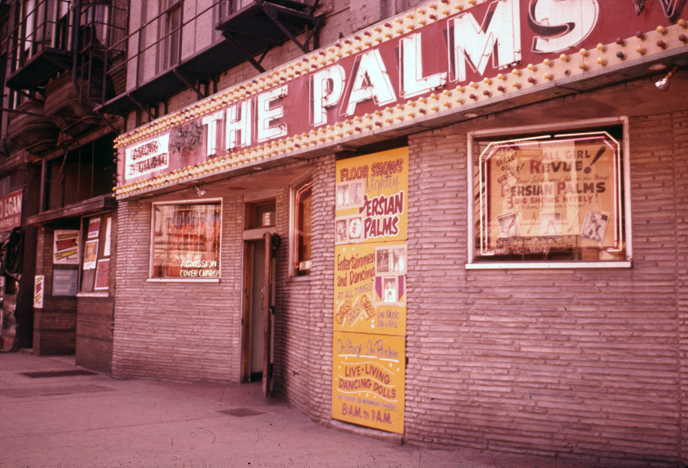
1961 Photo courtesy Hennepin County Library
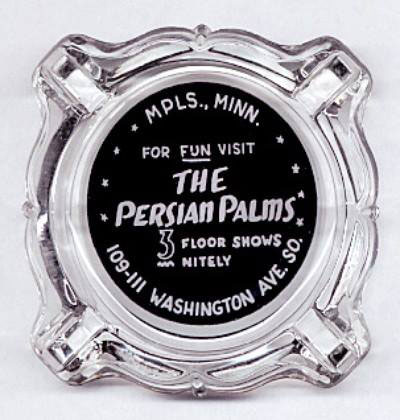
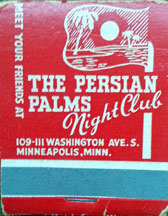

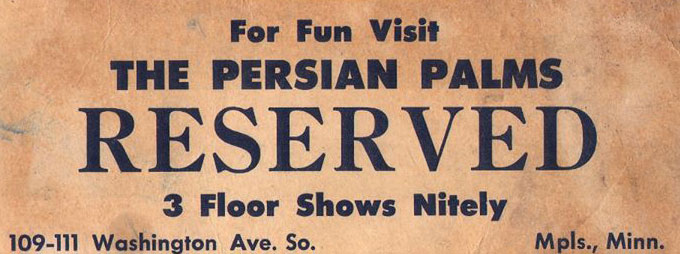
END OF THE PALMS
The last show of 10 Girls 10 was in mid-August 1961, and all fixtures and equipment were sold that same month. The building was demolished in August/September 1961 for the Gateway urban renewal project.
The building was first replaced by the International Business Machine Corp. building in 1963. This was a six-story building that had the address 245-299 Marquette Ave. It was one of the first replacement buildings to be erected in the Gateway Project.
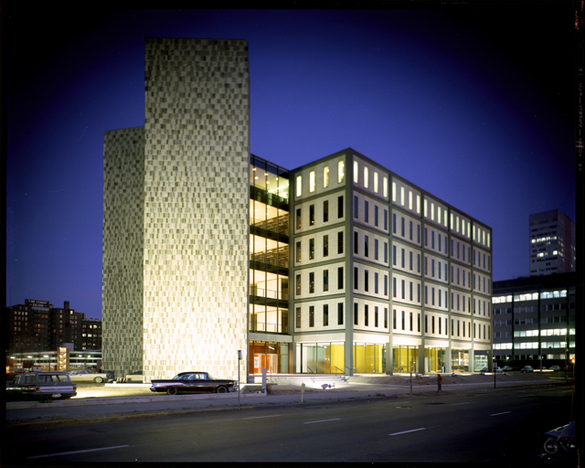
IBM Building, 1963. Photo courtesy Minnesota Historical Society
The IBM Building was also one of the first Gateway replacement properties to be demolished – it was removed in 1985 for the ING Reliastar 111 Building, which reverted back to the address 111 Washington Ave. So.
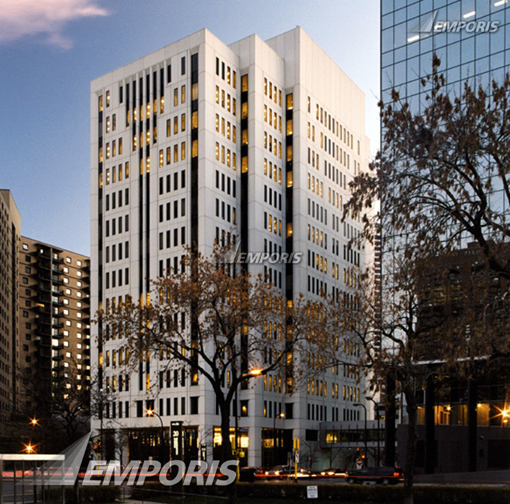
ING Reliastar 111 Building, November 3, 2003 – Emporis
HARRY SMULL AGAIN
In 1959 the Minnesota legislature made it unlawful for one person to have an interest in more than one liquor establishment in Minneapolis, but did not prohibit relatives from holding licenses. In June 1961, Smull and several others were indicted for having interests in more than one liquor licenses – in Smull’s case, seven, including the Persian Palms. In September 1961 the indictments were struck down on the basis that they were unconstitutional. (Minneapolis Tribune, November 12, 1961)
In 1963, when Smull expressed an interest in transferring the liquor license to a new place at 413 Hennepin, he was met with opposition; Alderman Robert MacGregor called the Palms “one of the raunchiest operations in town.” USA Confidential included it in a list of places that “cater to the lowest winos and blowsiest hags.” Smull was eventually approved to open the new place, the Copper Squirrel, in August 1963.
Harry Smull died in April 1972.
Phalen Park Shopping Center
1973. Country/rock.
Phil’s was located at 200 E. Lake Street, Minneapolis. Please see the Silver Dollar Club.
The Phyllis Wheatley House was a settlement house and boarding house for Negro girls called the Heart Center, started in 1922. In 1924, with support from the Community Chest, a former Talmud Torah building at 808 Basset Place was purchased. It was named for a slave who was purchased for four bundles of tobacco and who went on to become an accomplished poet. The facility opened on October 17, 1924, with the goal to “foster a wholesome leisure time program for men, women and children through its four departments: recreation, education, music, and dramatics.” In 1929 a new building was built at 809 Aldrich Ave. No. It provided many services, classes, entertainment, and more to the community. When black acts came to town and the hotels would not allow them to stay, they would stay at the Wheatley House. Many dances were held at the facility. The building was demolished when Interstate 94 was built through the neighborhood in about 1984. The present address is 1301 – 10th Ave. North.
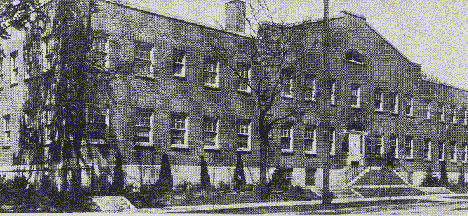
The building on Aldrich
Directions are a bit vague; on the Burnsville Crosstown, just east of 35W South. Did this last very long?

July 17, 1971
The Pine Tavern was at 301 Harrison NE in Minneapolis and featured the New Orleans Fizz, an Age-Old Southern Recipe Served in Authentic New Orleans Fizz Glasses, in July 1944.
The Pine Wood Club, a Friendly Place For Friendly People, was on County Road I and US Highway 8 on the Forest Lake Cut-Off. In 1944 it offered food and beverages always just right, and dancing.
In the spring of 1968 the Insider reported that Arnie Sagarsky was opening a new club for teens in West St. Paul. Not sure if this ever came to pass..
This page covers three related music venues:
- The Anglesey Cafe
- The Pink Pussycat
- The Filling Station
THE ANGLESEY CAFE
THE BUILDING
1327-1331 Hennepin Ave. (a/k/a 9 Spruce Place) was a three story brick veneer hotel built in 1907 at a cost of about $25,000. Its footprint was approximately 60′ by 90′. In 1915 the hotel became the 36-room Anglesey Apartments. The name Anglesey (often misspelled as Angelsey) came from an island off the northwest coast of Wales.
An Anglesey Cafe was mentioned once in April 1908.
1928
According to Cedric Adams’ column in 1953, the Anglesey was started in June 1928 by partners Joe Brush and George Sampanis. Brush was a well-known sportsman and hunter. (Minneapolis Star, June 11, 1953)
In 1928, a dramatic account of a shootout between proprietor George Sampanis and robbers blazed across the Minneapolis Star: “GUNS BARK AS CAFE OWNER DUELS BANDIT.” Despite the fact that Sampanis had a gun, the only casualties were a sugar bowl, the plate glass window, and lots and lots of dishes. The robbers got away with $121: money from the till, from Sampanis, and from the few customers in the place. (Minneapolis Star, May 28, 1928)
1930
Music from the Anglesey was broadcast over radio station WRHM.
1934
In 1934, Joseph S. Brush and Nick Sampanis (George’s cousin) were approved for a restaurant license. In 1935, they were approved for a license to sell intoxicating liquor, even though the Cafe was outside of the Liquor Patrol Limits.
Starting in 1934, the Cafe’s bowling team’s scores were in the paper every week.
1937
Again it’s a holdup that tells us who’s working at the Anglesey – at 5 am on February 27, 1937, a man climbbed into the building through a ventilator window and held up Tom Pappas, night man, and got away with $300 from two cash registers. The man failed to find an additional $500, but he did grab a handful of cigars as he made his escape back through the window. (Minneapolis Journal and Star, February 27, 1927)
1939
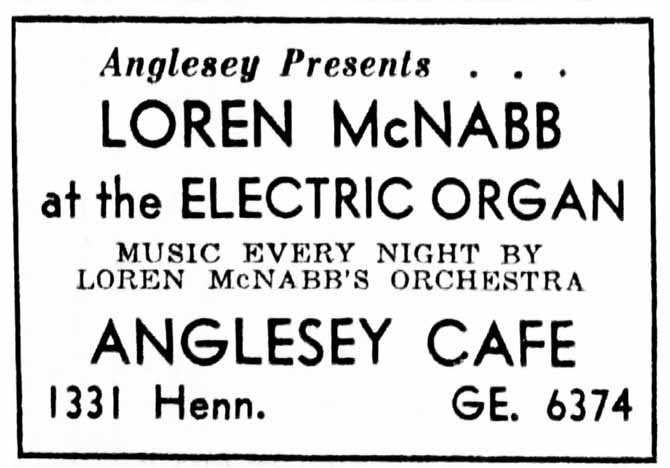
Minneapolis Star, January 20, 1939
In 1939, Eddie LaRue was the electric guitar playing leader of the four-piece house band at the Anglesey. Don Guthrie played an electronic keyboard called the Novachord, and the other two pieces were the clarinet and the “bull fiddle.” The band broadcast three days a week over phone lines over the radio. (Minneapolis Star, April 8 and June 27, 1939)
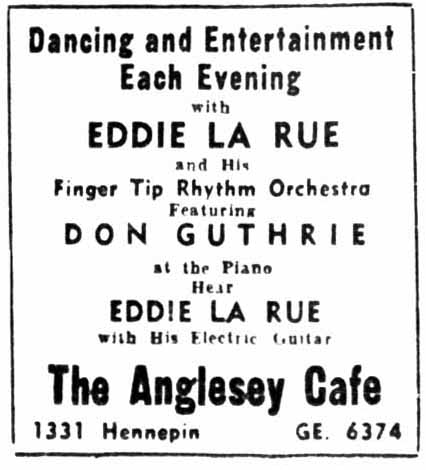
Minneapolis Tribune, February 7, 1939
The postcard below is undated, but perhaps it is of the era of this four piece band. We see the bass fiddle, and is that brown thing the Novochord?
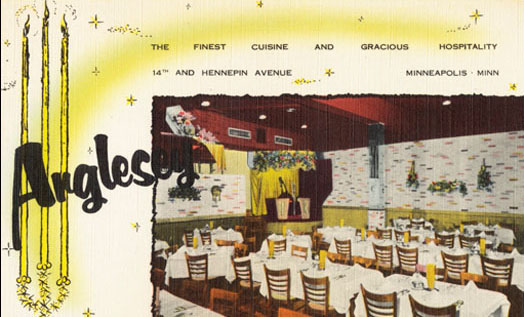
Image courtesy James Lilecs
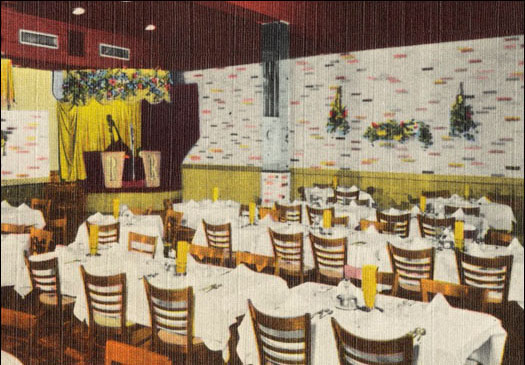
Here’s a closeup.
1940
The Cafe sponsored a Park Board baseball team and played teams sponsored by other bars and businesses, usually from Downtown Minneapolis.
Nick Sampanis, cousin of Joe Brush’s partner George Sampanis and co-holder of the original liquor license, died on August 4, 1940, at the age of 51. He was born in Greece and had spent 23 years working with George and Joe.
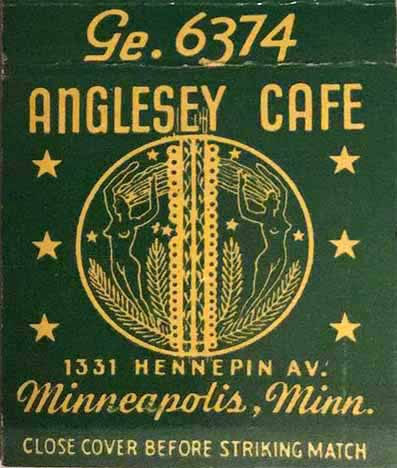
From the collection of Mark Youngblood
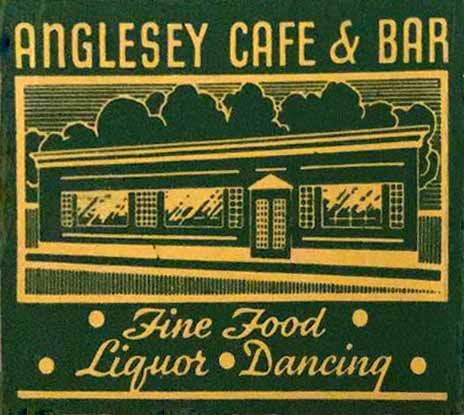
From the collection of Mark Youngblood
It would be nice to know that this is what the Anglesey looked like, except that we know it was on the first floor of a three-story building…
1941
Cedric Adams revealed this trick in his column:
Ever notice how thin the applause sounds from a supper club when the band goes into a broadcast or closes one? Joe Brush has solved the problem completely out at his Anglesey cafe. He copped the idea of Kitty Davis of giving each customer a little wooden mallet. During broadcast, Denny Beckner, the band leader, signals for applause, the patrons pound, and they sound like 2,000 enthusiasts. (Minneapolis Star, January 21, 1941)
If the mallets sound familiar, didn’t we see these in “Casablanca?”
Broadcasts from the Cafe were heard on WLOL radio.
An undated and unsigned memo (probably from the mid 1940s) says that the owner of record was the Minneapolis Bridge Co. but suspects that gangster Tommy Banks may have held the deed. (Clipping file, Hennepin County Library Special Collections)
Matchbook below from the collection of Mark Youngblood
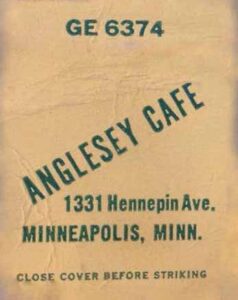
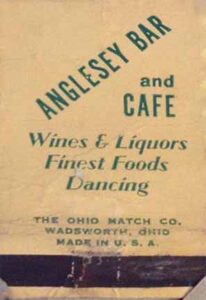
1945
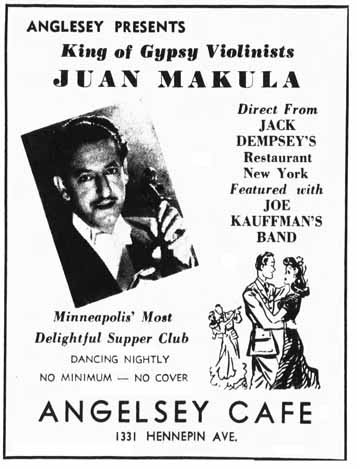
Minneapolis Daily Times, February 14, 1945
1946
In March 1946, owner George Sampanis was charged with discrimination by two black men who were not served at the bar. Each filed a $500 suit against Sampanis. The Minneapolis Spokesman reported that others had contacted the paper with complaints about discrimination. (Minneapolis Spokesman, March 15, 1946)
1947
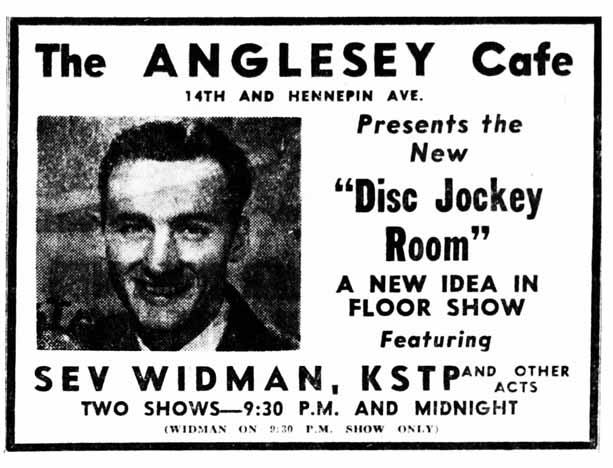
Minneapolis Star, June 12, 1947
In 1947, Sev Widman was emceeing the floor show in the new Disc Jockey Room. Will Jones described a couple of the vaudeville-type acts in his column that was mostly about the Cafe’s garlic bread. (Minneapolis Tribune, July 11, 1947)
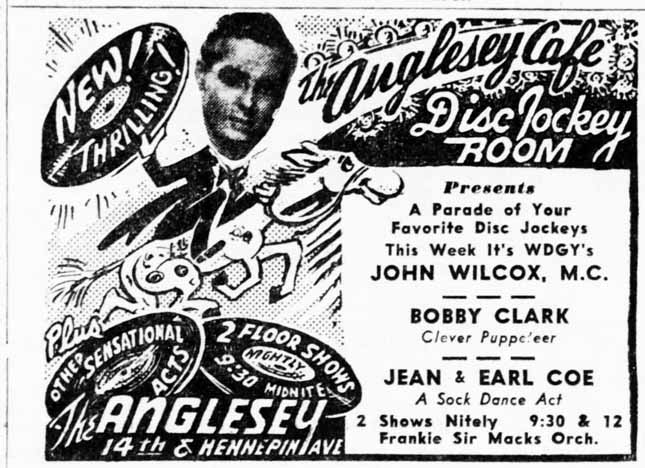
Minneapolis Star, June 17, 1947
1950
Air conditioning was added to the building in August 1950.
1953
Cedric Adams informs us that the Cafe was located in “automobile row,” and that owner Joe Brush has added a “nifty touch” called the Motor Lounge. The motif centered on antique cars and the days of early automobiling. The servers would wear dusters, caps, and goggles; prints of old cars would adorn the walls; small reproductions of early models would be scattered around the room, along with old headlamps, horns, and other motoring paraphernalia. A parade of 15 antique cars, valued at more than $75,000, was scheduled to tour “the loop” (Downtown) on opening night, September 1, and then park at the Anglesey for the night. (Minneapolis Star, August 28, 1953)
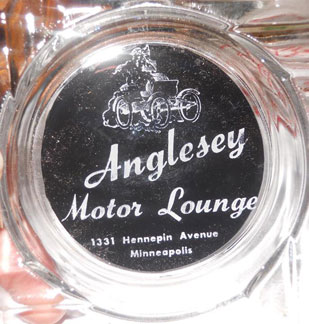
Ashtray from the collection of Mark Youngblood
Cedric Adams noted that June 1953 was the 25th Anniversary of the partnership between Joe Brush and George Sampanis “when they started their Anglesey cafe.” (Minneapolis Star, June 11, 1953) He was a little off, since we know that the place got robbed in May 1928, and what about that reference in 1908? The matchbook image below came from eBay and we can safely assume they are from 1953.
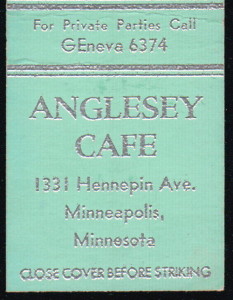
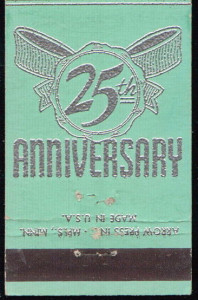
1955
One would think that it would be tough to rob a night club owned by a guy who is in the paper every week in the gun club section, but on August 5, 1955, the unthinkable happened: a gunman strolled into the Anglesey, unnoticed by nine customers and five employees, and robbed the cashier of $19,000 [16,000]. Authorities believed the holdup loot was the largest in Minneapolis since 1933, when members of the Roger Touhy gang of Chicago carried out a $78,000 mail robbery at the Milwaukee Depot.
Once the man had robbed the safe, which was full of check-cashing money, he locked the cashier in the safe, and she had to pound on the door until one of the bartenders heard her and called for Mrs. Brush to unlock the door.
At first the cashier was sure it was an ex-con who had just gotten out of prison, but he had an alibi, so the crime went unsolved. (Minneapolis Tribune, August 6, 1955)
On February 3, 1956, the same robber was back, but this time, the cashier foiled the attempt by ducking into a bullet-proof booth while the gunman fumbled for his revolver. Again, the only bartender and customer in the place didn’t notice the robber. “This is it again,” he said, as he pulled out his gun. But she was already in her safe cage and calling the police. (Minneapolis Tribune, February 4, 1956)
1957
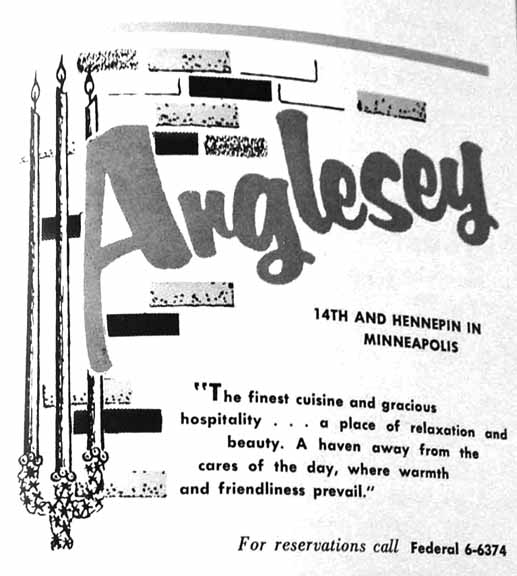
Image courtesy Mark Youngblood
1959
George Sampanis, Joe Brush’s partner since 1928, died on January 13, 1959, at the age of 66. George was born in Athens, and lived in Minneapolis for 49 years.
Jerry Henriksen was a violin player at the Angelsey for nine years before he was severely injured in a car accident in May 1958. After intense rehab, he was able to to play again, and Joe and Esther Brush kept his spot open for him. (George Grimm, Minneapolis Tribune, October 18, 1959)
1960
Joe Brush died on March 12, 1960, at the age of 62. Joe was born in Sheldon, Iowa, fought in World War I, and came to Minneapolis in 1925. He lived in the Anglesey Hotel, above the Cafe. He and wife Esther had a son, Joseph D.
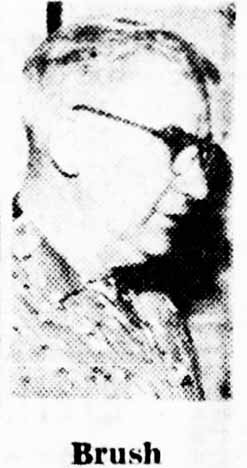
Joe Brush, Minneapolis Star, August 6, 1955
1962
On August 7, 1962, it was announced that Mrs. Harriet Sampanis and Mrs. Esther Brush, widows of the Anglesey’s founders George Sampanis and Joseph S. Brush, sold the building for $285,000. Purchasers were John Milne, former field representative for Minneapolis Brewing Co., and Jerry Henriksen, leader of the Cafe’s orchestra for the past 12 years. (Minneapolis Star)
1963
On July 2, 1963, a two-alarm fire rousted about 40 people living in 29 apartments in the upper two floors of the Anglesey Apartments. No one was injured. The fire started in a liquor storeroom in the basement of the bar of the Cafe. The first alarm was souned at 3:37 am. Damage was estimated at $5,000. (Minneapolis Star, July 2, 1963)
The ad below may have signaled the reopening after repairs from the fire.
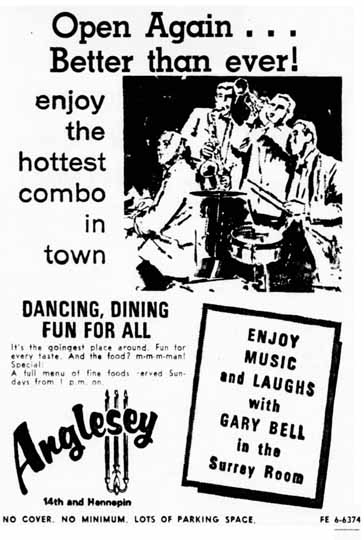
Minneapolis Tribune, July 20, 1963
On November 29, 1963, the R.L. Burns Co. requested that its licenses at the Anglesey Cafe and Bar be transferred to a new corporation called Marro. Marro consisted of Marvin S. Goldman, manager of the Carousel Lounge, operated by his mother, Rose; Sanford Rosen, an accountant; and Israel Mirviss, an attorney. The arrangement was that Marro would lease the Anglesey from the Burns Co. and pay $50,000 for the establishment’s good will. The lease arrangement called for the payment of $61,200 for five years, with an option for an additional five years at $66,000. (Minneapolis Tribune, November 30, 1963)
Will Jones wrote that Marvin Goldman’s first concern would be to restore the Anglesey’s kitchen to its former state of excellence. “Then they’d throw out rock ‘n’ roll and folksingers, redecorate, bring in a dance band specializing in businessman’s bounce, and hope that the place would bounce once more as of yore.” (Minneapolis Tribune, December 5, 1963)
1964
In 1964 there was the Regency Room for dining and dancing and the Surrey Room Piano Bar.
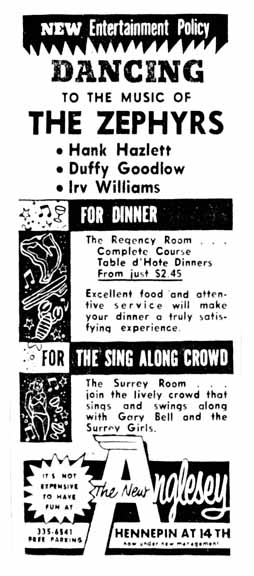
Minneapolis Star, June 25, 1964
In August and September 1964 there was a run of hypnotists to entertain the crowds. Will Jones wrote about the “revived” Anglesey Cafe that was “going in for shows now. Besides the hypnosis, Sherry Seimone was singing, and the Irv Williams-Hank Hazlett combo was playing for dancing. (Minneapolis Tribune, August 12, 1964)
Things moved fast, and by November 1964, we had the Anglesey a Go Go. Shoeshine girl Jack Rubin was spinning records, and hostesses in fringed dresses demonstrated dances, danced with customers, and doubled as waitresses. 1965 was really the year of the Go Go, so they were a titch ahead of the curve. (Will Jones, Minneapolis Tribune, November 12, 1964)
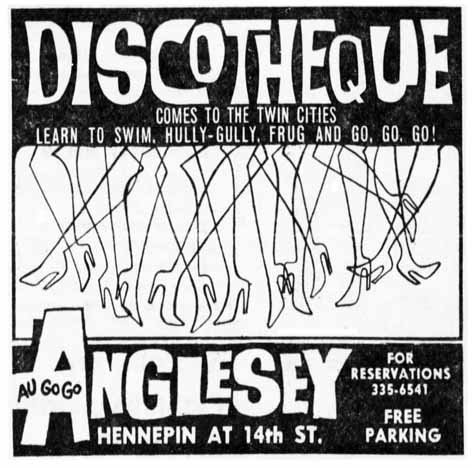
Minneapolis Tribune, November 12, 1964
1965
THE PINK PUSSYCAT
No one tells the story of the transition from the Anglesey to the Pink Pussycat better than the wonderful Mr. Will Jones of the Minneapolis Tribune, so here is his column of March 2, 1965, in full:
Dial the Minneapolis information operator, ask for the Pink Pussycat, and she’ll tell you there’s no such place listed. Well, she just hasn’t caught up with things.
Yes, Minneapolis now has a Pink Pussycat saloon. The sign went up last week, the walls got a new paint job over the weekend, and pretty soon there will be murals showing pussycats both pink and black. And there will be waitresses in Pink Pussycat costumes. This is what has become of the old Anglesey Cafe.
The original Pink Pussycat, in Los Angles, is a combined saloon, striptease parlor, and striptease school where Lenny Bruce’s mother is in charge of the novice stripteasers. On the program there’s always a girl who wears a costume made of pink ostrich-tail feathers, and the customers are allowed to pluck the pink feathers as souvenirs.
In Minneapolis, however, things will be quite different. This one won’t be a strip joint.
The Anglesey abandoned its discotheque policy. The same kind of dancing still goes on, but with a live band, the Belvideres, supplying the music. And there are hostesses to teach the Watusi and the frug.
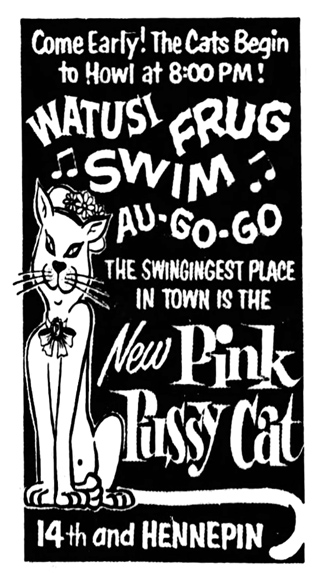
Minneapolis Star, March 12, 1965
OUR SWINGING NIGHT LIFE
The Pink Pussycat was featured on the cover of a special section of the Sunday Tribune Picture Magazine (October 17, 1965) called “Our Swinging Night Life.” Apparently there was at least one guy caught dancing with a woman who was not his wife, and the stuff hit the fan…
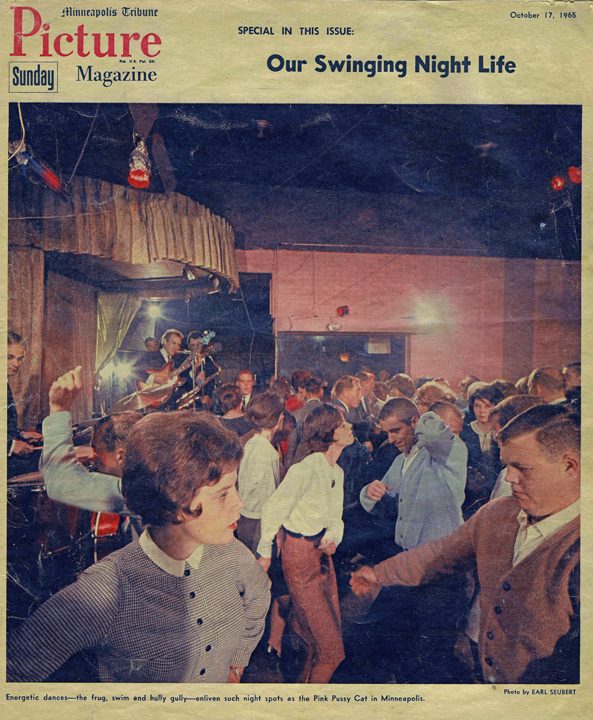
Courtesy Joey Strobel via minniepaulmusic.com
1966
I find quoting Will Jones irresistible. Here is his column of June 14, 1966, where he provides a wealth of information about what must have been an amazing place.
The Pink Pussycat now has go-go girls. That’s not news? I didn’t think so, either, but I have been corrected.
When the Pussycat first went in for the discotheque type of action, it was one of the first places to have waitresses in fringed dresses who would do the new dances with the customers, teaching them, if necessary. Those were not go-go girls, according to the management.
For some weeks, the place has been relying on the customers alone for dance action. And Joey Strobel’s big-band-sound rock with two saxes and an organ alongside the standard guitar and drums, has kept the dance floor packed. The business of the kids not touching each other when they dance just doesn’t work here. The floor is too crowded.
Last week, to amuse those who do not choose to engage in the battle of the dance floor, two authentic go-go girls were installed. They work on table-high platforms in the middle of the room.
When Strobel is on, everything in the room rocks, including the lights. He has a panel of foot switches that control the spotlights on himself, the dance floor, and the go-go girls, and the colored lights flash on and off to the beat, sometimes here, sometimes there. Otherwise, the place is kept candlelight-dark and the waitresses and hostess all carry flashlights.
There used to be a front bar and a back room in the place, but those have disappeared. The walls have been torn out to make one large room. Air conditioning pipes have been exposed, and so has the employes’ time clock in what used to be the kitchen, and the whole place has a stripped-for-action look a little startling to anyone who remembers the old Anglesey Cafe, or even the original Pussycat. There’s rope-at-the-door business on weekends.

Matchbook from the collection of Mark Youngblood
1967
Joey Strobel and the Runaways was basically the house band from the beginning of 1967 until the end of the year, when they moved to George’s in the Park.
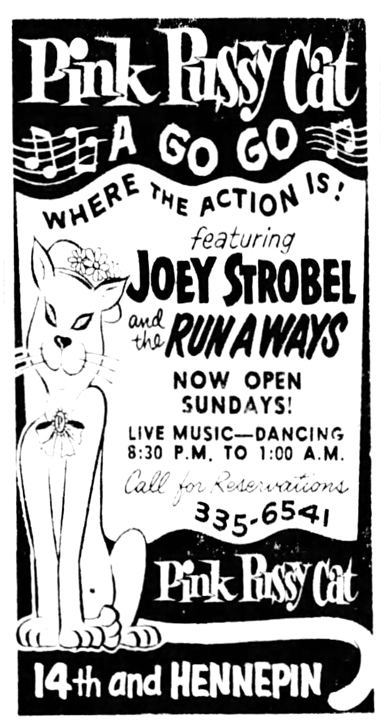
Minneapolis Star, April 20, 1967
1968
BILLY GRAHAM SPOILS THE FUN
On January 17, 1968, the Minneapolis Star announced that a subsidiary of the Billy Graham Evangelistic Association had purchased the Pink Pussycat. The price was not disclosed. The building was slated for demolition, and the site would be used for expansion of the association’s facilities – either a new building or a parking lot. The new owners would take possession of the building on January 28, 1968.
Ads appeared on January 21, 1968, seeking to sell off the Club’s equipment.
The building was demolished in July 1969.
In 1976 the Minneapolis Community and Technical College was built on the entire block.
THE FILLING STATION
Marvin S. Goldman, as head of Marro Corp., still owned the Pink Pussycat business, and his plan was to move the club across Spruce Street to a renovated building at 1401 Hennepin Ave. The Minneapolis City Council had already approved the transfer of the liquor license to the new location. Goldman had hoped to open for business in its new location on January 29, 1968, if his equipment arrived in time. (Minneapolis Star, January 17, 1968)
The new place didn’t turn out to be a new Pink Pussycat and it didn’t open in January, but it turned out to be a successful business for several years.
The building started out as a one-story 48′ by 80′ brick auto shop built in 1904 – this was “automobile row,” after all. In December 1967, Goldman put $42,000 into building a 46′ by 30′ addition and rehabbing the entire place. When Don Morrison saw it he called it a new building.
The Filling Station opened on March 5, 1968. Management seemed to have a proclivity for booking non-local bands.
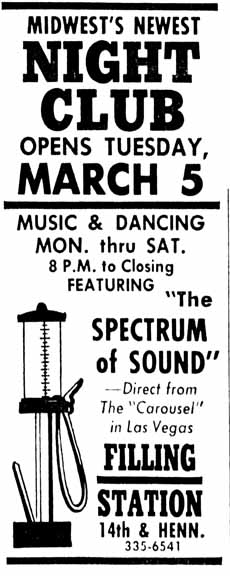
Minneapolis Star, March 4, 1968
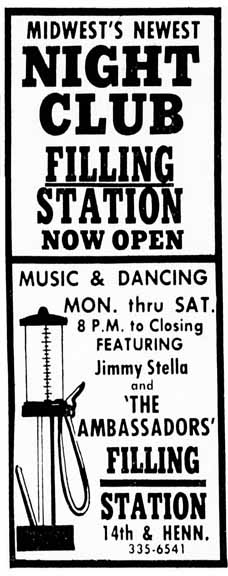
Minneapolis Star, March 8, 1968
Don Morrison gave an excellent description of the club in an early column:
The decor goes with the name without being sticky about it. Door handles are made out of gas nozzles. Lighting fixtures include those flat round glass globes bearing oil company brand names that used to surmount old-fashioned gas pumps.
Goldman said he had hoped to find entire pump units, but that several expeditions around the rural countryside failed to turn up any antiques. But the globes collected by the Winona Light Co. (including one for “Phillips Unique”) are authentic.
The main room is commodious, carpeted and with terraces for tables. There is a dance floor to serve the pop-rock policy of entertainment. A very handsome piano lounge adjoins this area and there also is a street bar for a less musically inclined clientele.
(Minneapolis Star, March 30, 1968)
1969
Here’s an odd name for a female band in an era of women’s liberation. Our local band was called the 19th Amendment, for the Constitutional Amendment that authorized women to vote!
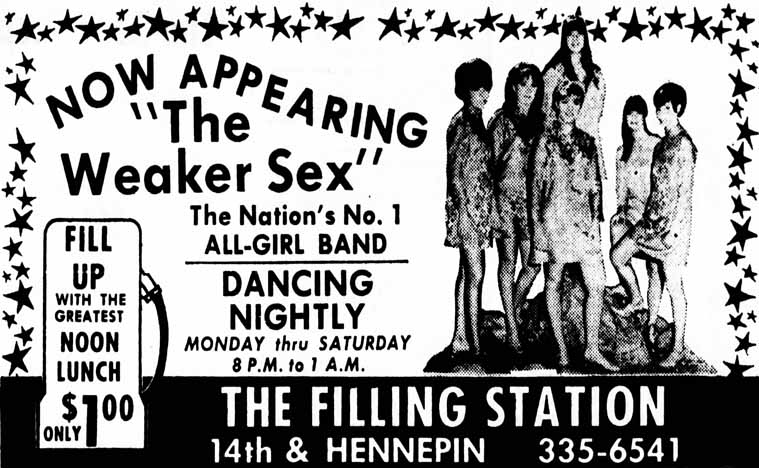
Minneapolis Tribune, January 30, 1969
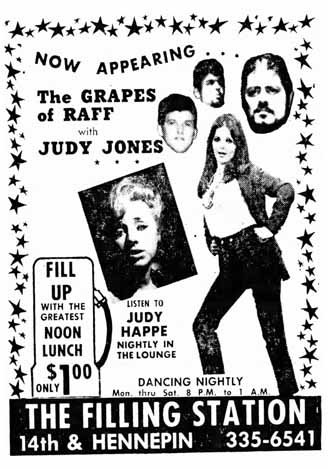
Minneapolis Star, April 25, 1969
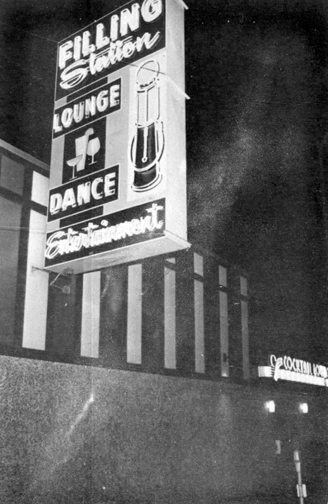
May 1969. Photo copyright Mike Barich
1970
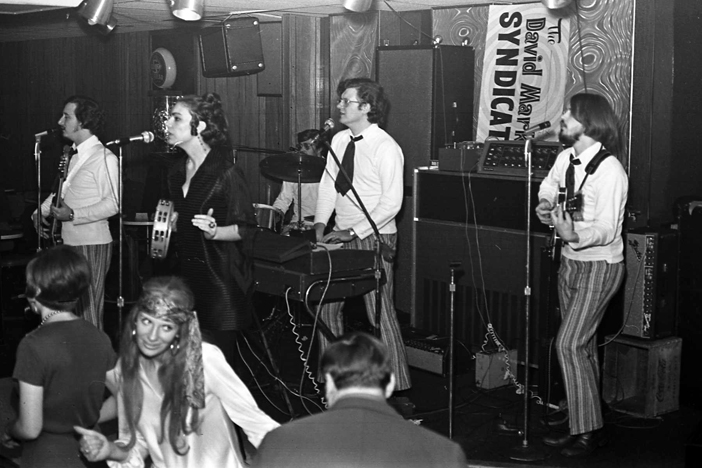
Dave Mark Syndicate, January 28, 1970. Photo copyright Mike Barich
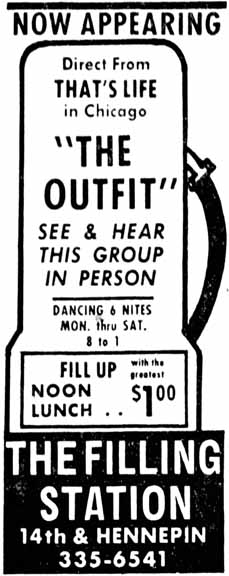
Minneapolis Star, March 6, 1970
Matchbook images below courtesy Deb McKay
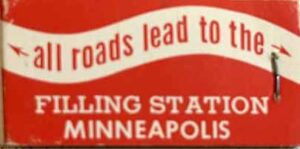
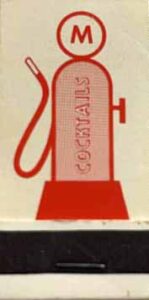
1971
In September 1971, a TV tower was installed, and they began to show NFL football (reservations requested). And had the Filling Station gone Country? The paper’s description still said “Dancing to Rock Band,” but Texas Bill was a Country singer.
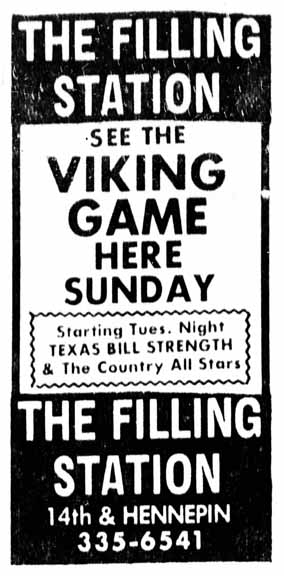
Minneapolis Tribune, November 5, 1971
On November 14, 1971, several bars like the Filling Station that had purchased antennas to pick up local Vikings games that were blacked out on local channels were met with snow or black screens. The theory was that someone from Mason City, Iowa, had planted jammers on their lines so that they could not watch the Minnesota/Green Bay game in the comfort of their local bar instead of at Metropolitan Stadium. Customers were livid, and as the jamming devices were removed, signals were traced to find out who was doing it. The jammer found at the Filling Station was one of three found in the City. Such jammers violated Federal law and the FCC and the FBI got involved with the investigation.
1973
The last classified ad found for the Filling Station in the Minneapolis Star is for a cook, and is dated May 8, 1973.
END OF THE LINE
Like its predecessor, the Filling Station was also doomed to redevelopment. The building was demolished in October 1975. The entire block became the Minneapolis Community/Technical College, built in 1980.
588 Rondo Street, St. Paul. Site of a dance sponsored by Boyd’s Super Service on December 9, 1938.
150 N. Concord in St. Paul in 1943. I don’t know if they had entertainment but I just liked the name.
The Pizza Plaza at 621 Excelsior Blvd. in Hopkins featured jazz trios in 1958.
A March 1964 ad in the Echo says “Every Sunday Night 6-10 Join the Blazemen for a Hootenanny in the Back Dining room of the Pizza Plaza”
This is the story of the building at 724 Fourth Ave. So. in Minneapolis.
THE VENUES
This building had a dizzying array of entertainment venues over its 75 year life; this may not even be a complete list:
- Eagles Hall
- Pla-Mor Ballroom
- CIO Hall
- FDR Memorial Hall
- Diamond Lil’s
- Times Square
- Friar’s Dinner Theater
- Friar’s Minnesota Music Hall Dinner Theater
- Chimera West
- Betty Jo Byoloski’s
- Off Night Music Hall at the Downtown Dinner Theater
- Central Park
- Down Under at the Haymarket
- Herald’s Christian Supper Club
- Music Box
- Discotrec II
- Little Al’s
- Dave Rooney Lounge
- Friar’s Cabaret
- Music Preserve
THE BUILDING
Minneapolis permit cards for 718-28 4th Ave. So. indicate that a brick office building was built at this location in 1906. (A tenement building was also on the property in 1904, but it was razed in 1919.) Several additions were made, and the final footprint was 82 ft. by 134 ft. by 24 ft.
The building had two stories and a basement, which makes tracking the different venues in it somewhat difficult. I’m aware that some of the venues below overlap. Presumably the second story was an open hall, based on uses noted on the permit cards.
The first use of the building shown is a shoe shop in 1915, probably on the first floor.
EAGLES HALL
In 1925 it was a lodge or “Community Club Building.” This may have been the period when the building served as the home of Eagles Aerie No. 34. The photo below is from 1950, but you can see Aerie No. 34 etched above the door. Aerie No. 34 still exists and hosts dances on a regular basis in another location.
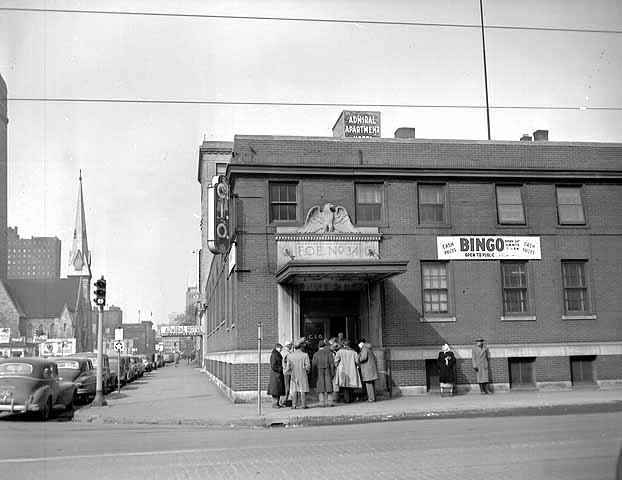
CIO Hall in 1950 – Minnesota Historical Society
In 1941, Aerie No. 34 moved to the second floor of the Transportation Annex Building, 4th Street and 2nd Ave. So. The space was leased and the Eagles spent $10,000 remodeling it for their use.
PLA-MOR BALLROOM
In 1933 the building was listed on the city’s permit cards as a dance hall. The first mention of the Pla-Mor Ballroom shows up in the Minneapolis papers on October 12, 1934. In the 1930s it was the site of Barn Dances hosted by Thorstein Skarning.
There were other Pla-Mor Ballrooms around the State, including:
- The Pla-Mor Ballroom at 1904 E. 9th St. in Glencoe, owned by Raymond T. Olson. It is the only one remaining.
- Pla-Mor Ballroom on Highway 7 in Silver Lake. Advertised in Minneapolis papers until 1956. That year the Pla-Mor in Silver Lake was owned by Mr. and Mrs. Harry Dostal, who appealed the provision in the Dance Hall act that prohibited the sale of 3.2 beer – they won in June in 1956.
- The Pla-Mor Ballroom at 2045 14 Hwy E in Rochester. Jerry Lenz of the Nickel Revolution found this notice of its demise in December 2006: “The Pla-Mor Ballroom, where Rochester area couples danced to live bands for more than half a century, now has disappeared into a pile of rubble and into city history. The 55-year-old building would have been too costly to restore.” It had been put up for sale in 1973.
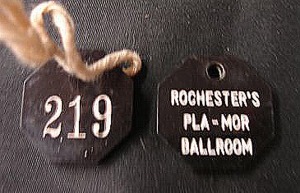
- There was a Playmor Ballroom in Pipestone – a misspelling or another franchise?
- Pla-Mor Roller Rink is at 1422 E US Highway 169 in Grand Rapids.
The last mention of the Minneapolis Pla-Mor shows up in 1946.
CIO HALL
On October 29, 1943, the “old Eagles Hall” was purchased by CIO (Congress of Industrial Organizations) Locals 1139, 1140, 1145, and 1146 of the United Electrical, Radio, and Machine Workers Union of America. The building was purchased to house state CIO headquarters and headquarters of other CIO unions which had been located at 1126 Harmon Place. There were 10 office, a main hall seating 1,500 people, seven smaller halls seating up to 400 people each, and kitchens. Howard Fortier was chairman of the CIO Hall committee in charge of the building.
Grand opening of the building was scheduled for October 30, 1943. Nine vaudeville acts and dancing were scheduled as entertainment at the grand opening.
During its CIO Hall days the building was mostly used for political and union meetings, but there were also some concerts and dances held here.
In 1944 you could dance to Bud Strawn’s Orchestra every Saturday night, and if you were in the service you could get in free of charge. Dances were held there until at least 1952. In 1955 it was still listed as a “labor hall” on its permit card.
Lucky Millinder and his band appeared at the Hall on July 28, 1946.
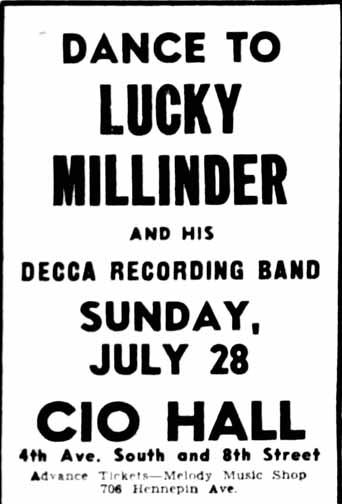
This ad appeared for the Ernie Bjorklund band, which appeared at the CIO Hall every Sunday Night in 1947.
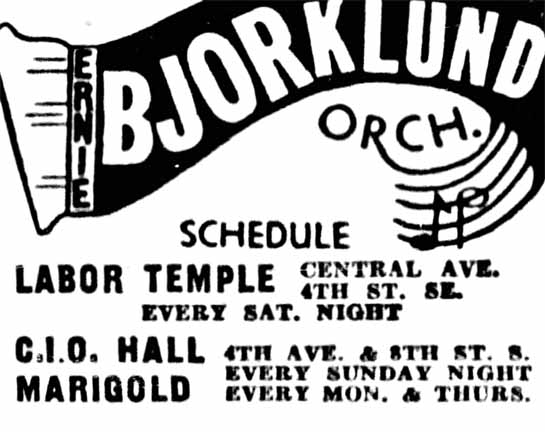
Earl Bostic and his Orchestra appeared for a Thanksgiving dance on November 25, 1950.
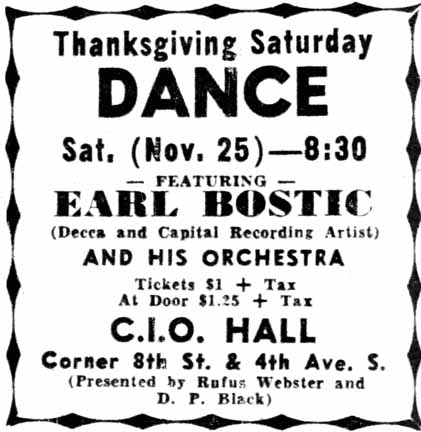
FDR MEMORIAL HALL
The building was referred to as the FDR Memorial Hall in an article dated August 31, 1958 in the Minneapolis Tribune. There were other entries before that for a Memorial Hall, but no address was given.
Will Jones described it as a labor union meeting place.
In 1966 the building was sold. At this point we will have to divide the building into Upstairs and Downstairs, as they had different venues at different times.
UPSTAIRS
DIAMOND LIL’S
In July 1966 the upstairs was transformed into Diamond Lil’s, a nightclub with a Gay ’90s motif. Diamond Lil’s was originally a private or “Key Club.”
(In March 1966 there was a different Diamond Lil’s Bar at 3607 Washington Ave. N. This one eventually succumbed to a fire.)
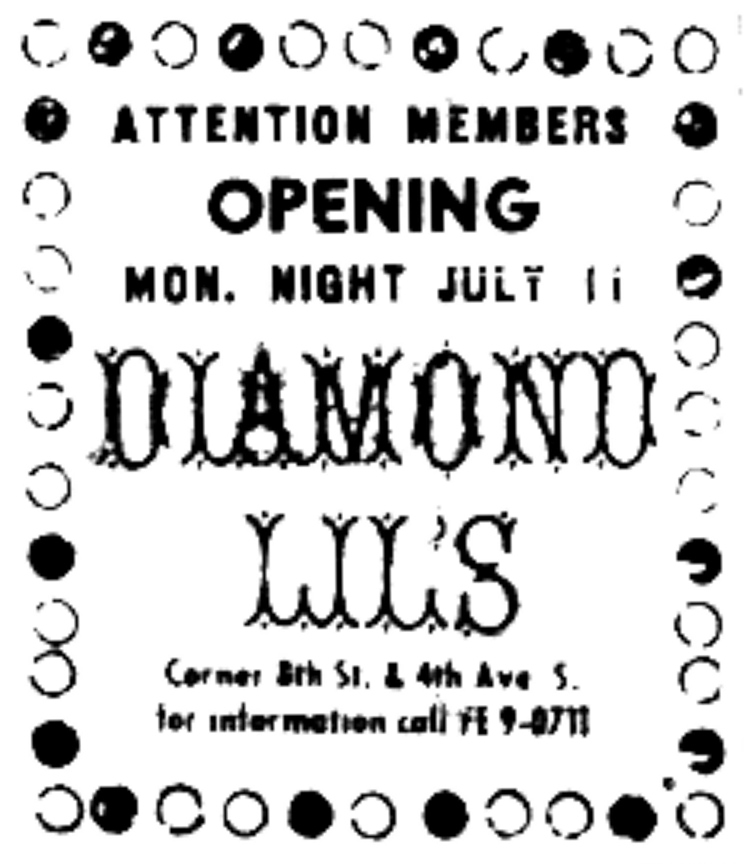
1966
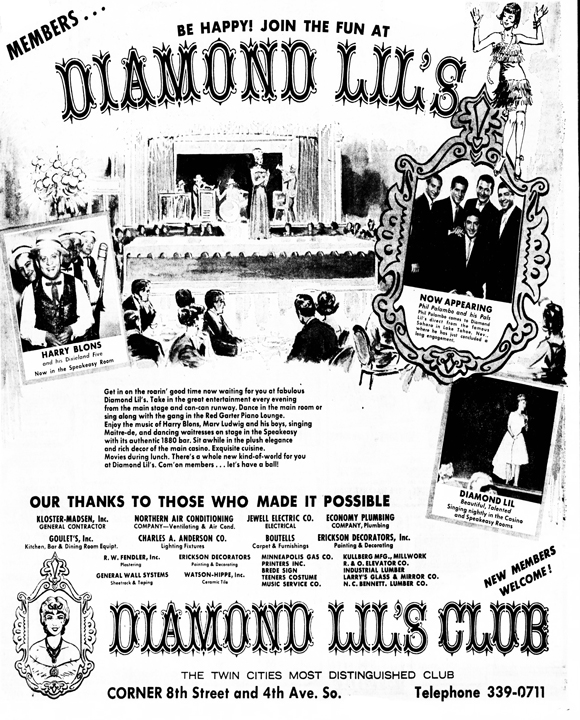
Minneapolis Star, August 25, 1966
Diamond Lil’s brought in name acts that appealed to an older set (Helen Forrest, Bob Eberle, Julius LaRosa), and brought in a revue that featured a couple of topless showgirls.
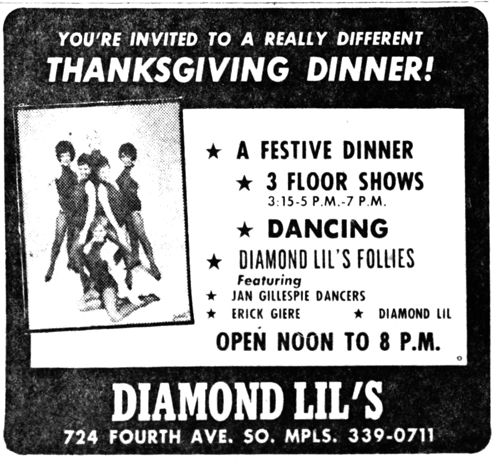
Minneapolis Star, November 17, 1969

Minneapolis Star, March 2, 1967
By October 1967, Diamond Lil’s was “Open to Everyone!”
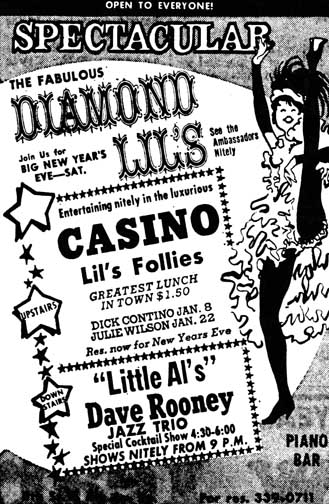
October 1967
Gregory LaLonde says that the band The Blue Fox played there on election night, November 1968 and that it was “quite a place.”
In about August 1969, prominent businessman Jack Dow purchased the building “as a hedge against losses” from the Hotel Hastings, which he also owned. His plan to make money on Diamond Lil’s to make up for losses on the hotel didn’t exactly work, though – little did he know that the building was cursed.
Dave Rooney was a regular at Diamond Lil’s, and recorded an album there, appropriately called “Live at Diamond Lil’s.”
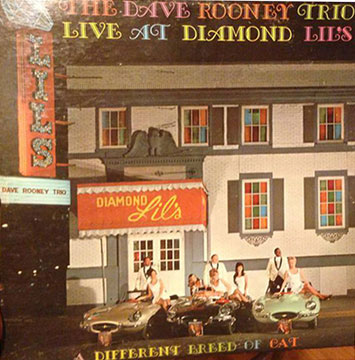
I love this fantasy album cover, with the Trio showing off their cars and groovy chicks. Here’s a closeup:
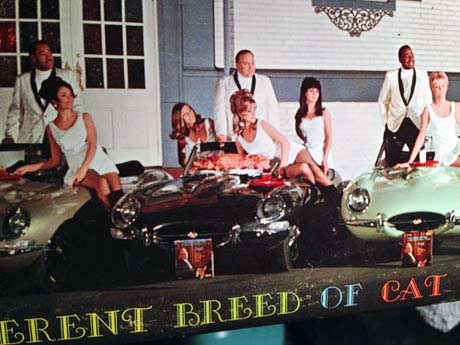
TIMES SQUARE
It became clear that the Diamond Lil’s concept wasn’t bringing in the crowds, and it was time to do something else. Owner Jack Dow made an agreement with Danny Stevens, leader of Danny’s Reasons, to let Danny run the entertainment. The new rock club was renamed Times Square, and it opened on October 3, 1969. Bands on hand were Soulsberry Jam, Zarathustra, Cisco Grove, and Danny’s Reasons.
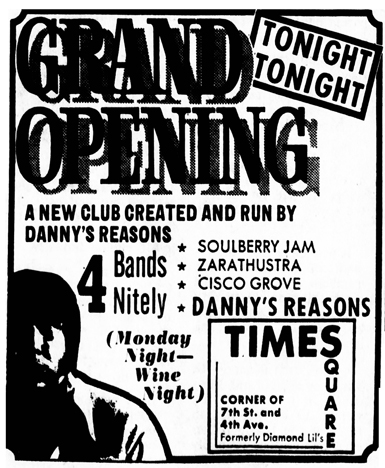
Minneapolis Star, October 3, 1969
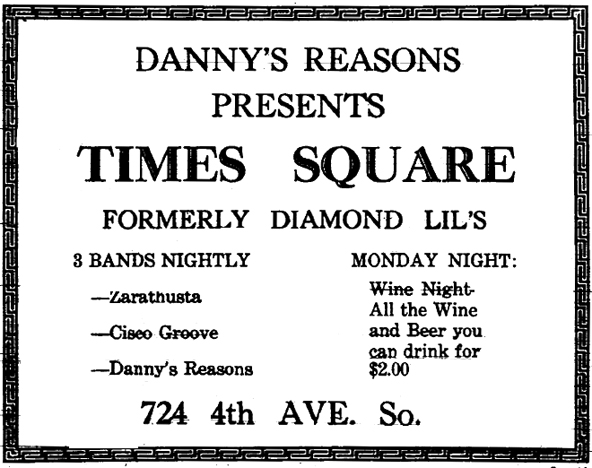
Ad from the Minnesota Daily courtesy Robb Henry
From the first, the club featured Monday Wine nights, where patrons could buy a cup for a certain price and get as many refills as they wanted. Danny said that the wine was Bali Hai, and the night was especially popular with college professors!
Jeanne Ray with the Village Knights provided music for dancing in 1969.
Ads in the Minneapolis papers indicated that entertainment was provided by mostly local bands. Danny said that national musicians would come over after their shows at bigger venues and jam into the night here.
THE NICE
One national band that performed at Times Square was The Nice, featuring Keith Emerson. An email inquiry from Karl Speck wanted to track down the exact date of this performance, because it was not mentioned in the Minneapolis papers. Danny remembered,
I think it was the Wednesday night before Thanksgiving or Thanksgiving night. I also remember it was one of their last shows before becoming Emerson, Lake, and Palmer. They were brought in by Timothy D. Kehr and he got free radio advertisement for the show.
Another website confirms that The Nice were at Times Square on November 26, 1969, the day before Thanksgiving. The Nice played its last show on March 31, 1970, before regrouping into Emerson, Lake & Palmer. Thank you to Karl and Danny for their remembrances, 54 years later!
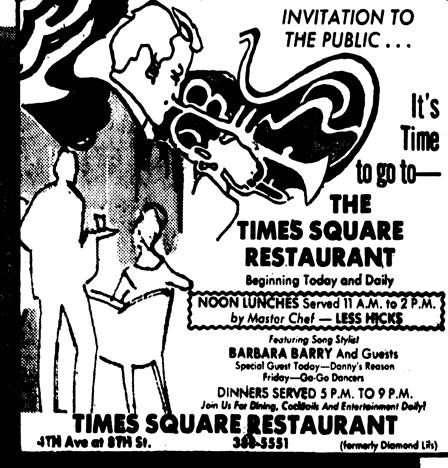
Minneapolis Star, October 16, 1969
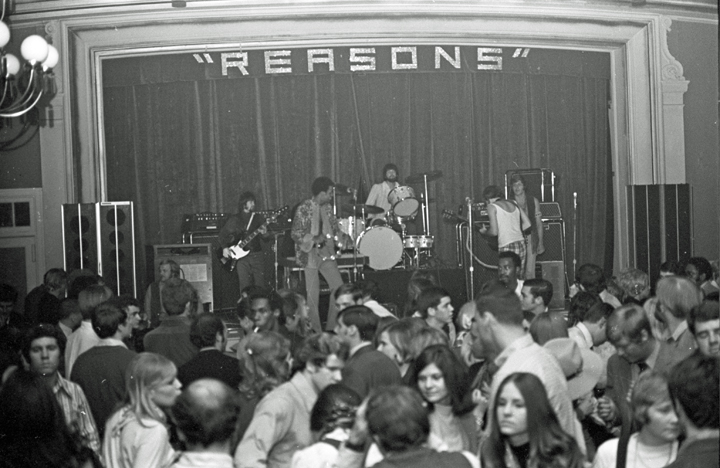
Times Square stage – photo copyright Mike Barich
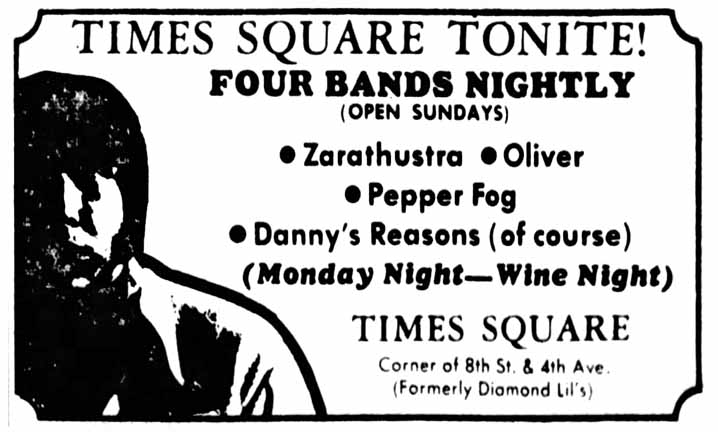
October 17, 1969
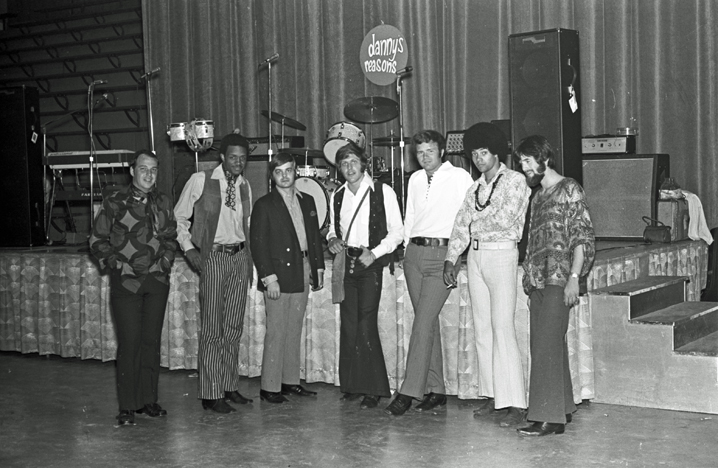
Danny’s Reasons at the stage – photo copyright Mike Barich
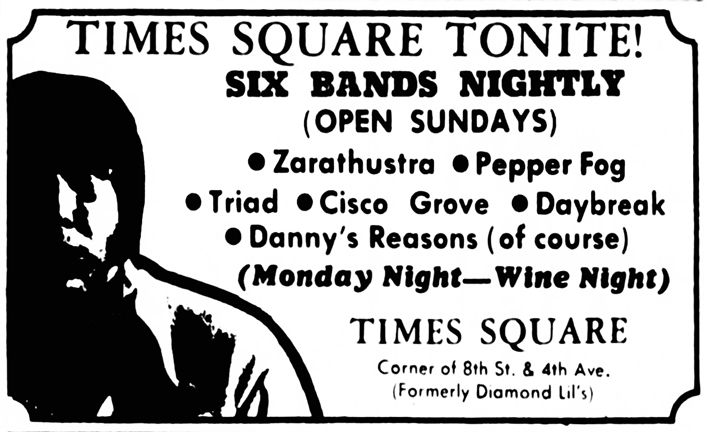
Minneapolis Star, October 24, 1969
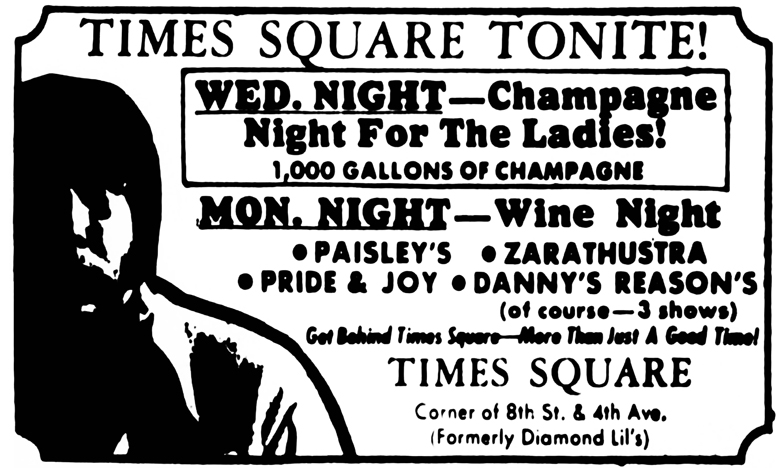
Minneapolis Star, November 19, 1969
Times Square lasted until about February of 1970.
FRIAR’S DINNER THEATER
An article dated January 4, 1970, indicated that the building had been leased by Stuart Schwartz and Bill Roslansky. In turn, they entered into an agreement with Dick Shapiro and Bill Semans to turn the place into the Friars, a theater-nightclub-restaurant, not to be confused with a dinner theater. Their plan was to bring in off-Broadway shows. The first show, “The Boys in the Band,” was scheduled to open on February 3, 1970. (Minneapolis Tribune, January 4, 1970) It turned out that this plan never came to pass. (Tribune, February 8, 1970)
On March 18, 1970, the upstairs became the Friar’s Dinner Theater, run by Bill Roslansky and Stuart Schwartz. The first production was Neil Simon’s “Come Blow Your Horn,” produced and directed by Stockton Briggle.
In July 1971, owners Bill Roslansky and Stewart Swartz sold the Friars Dinner Theater to the Hotel Hastings, owned by Jack Dow. (Minneapolis Star, July 29, 1971)
Jeff Lonto sent the image below, saying “This came from a magazine called Today In The Twin Cities, September 8-14, 1973. It was published by TV Times and had a TV listing section plus ads and listings for restaurants and night clubs, and was apparently given away in motel lobbies. The “fabulous fifties” guy in this ad looks more like he’s smack dab out of September 1973.”
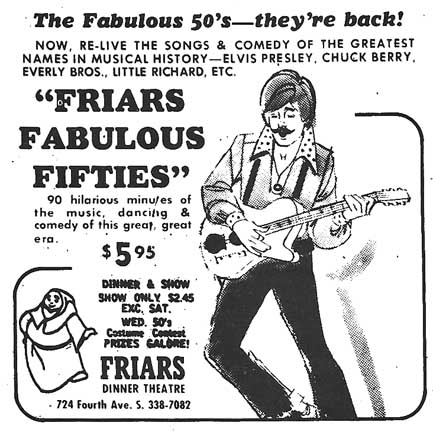
FRIARS MINNESOTA MUSIC HALL DINNER THEATER
On January 29, 1974, it became the Friars Minnesota Music Hall Dinner Theater, Ray Carlson, Manager. It had a capacity of 500. It closed in March 1975.
Chimera West: Jim Borland, August 21 to December 13, 1975.
Betty Jo Byoloski’s: February 15 to December 1, 1975. Apparently all of the wait staff were in costume and none had any serving experience.
Off Night Music Hall at the Downtown Dinner Theater: Opened Fall 1976 to about March 1977
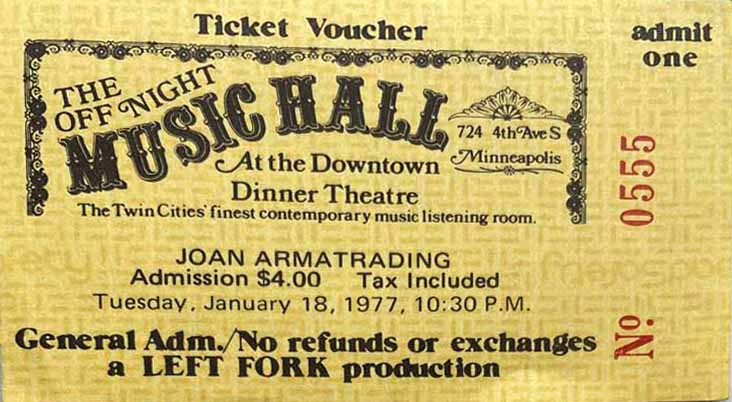
January 18, 1977, ticket image courtesy Curtis J. Metcalf
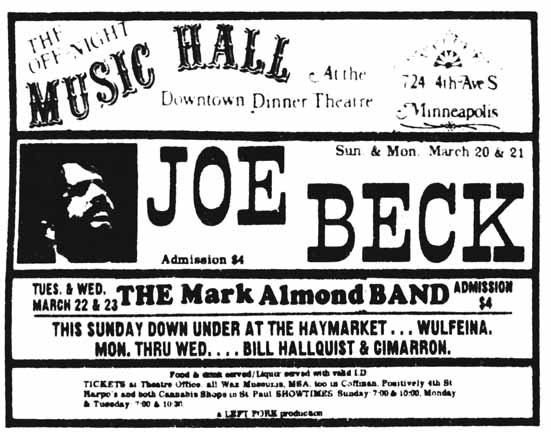
March 20, 1977
CENTRAL PARK
Central Park Disco was run by Lee Swearington, from December 1975 to January 1977.
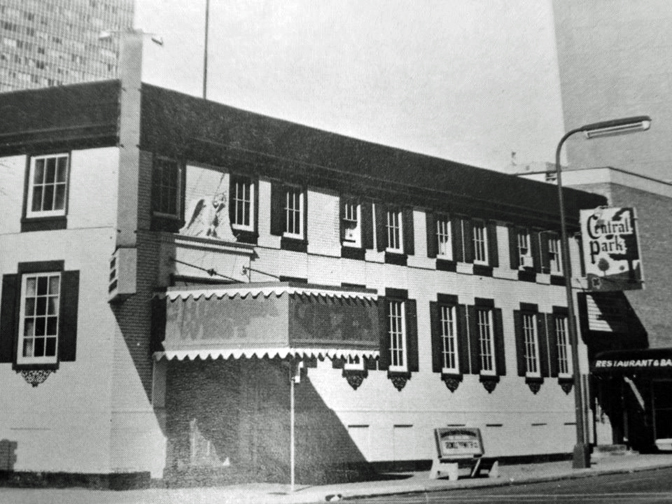
Central Park – Photo courtesy Alan Freed
Down Under at the Haymarket: 1977
Jack Dow lost the building in bankruptcy in April 1977.
Herald’s Christian Supper Club opened on December 31, 1977. It moved downstairs in August 1978.
Music Box: Dale Olson was the owner/manager in August 1978.
Discotrec II, a Teen Disco patterned after a similar operation in Eagan, opened upstairs in January 1979. Herald’s had moved downstairs for lack of business.
DOWNSTAIRS
LITTLE AL’S
In 1967, Dave Rooney moved into the downstairs of Diamond Lil’s and called the new place Little Al’s.
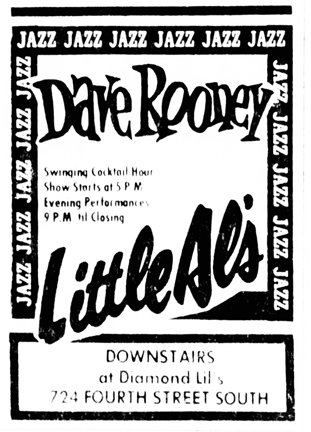
Minneapolis Star, February 9, 1968
Rooney moved out of the building in December 1969 in the face of dropping profits. His new digs were the basement below the Roaring Twenties.
DAVE ROONEY LOUNGE
By May 24, 1970, Rooney was back, and the downstairs had become the Dave Rooney Lounge.
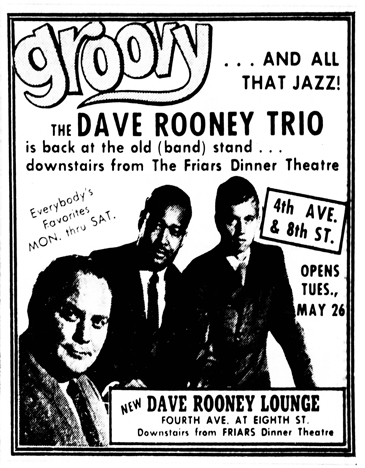
Minneapolis Tribune, May 24, 1970
FRIAR’S CABARET
By about March 1972, however, the downstairs had become the Friar’s Cabaret, again frustrating attempts to keep jazz alive in the Twin Cities.
In October 1972, Strib columnist Irv Letovsky reported that a recent policy to bring in name acts to the downstairs cabaret wasn’t doing so well – a show in September with Rudy Vallee only brought in 66 paying customers.
The Music Preserve opened on June 7, 1977, replacing the Friar’s Cabaret.
In August 1978, Herald’s Christian Supper Club moved downstairs.
Perhaps after determining that the building was cursed, it was mercifully demolished in August/September 1981. The site is now the 33-floor SPS Tower, built in 1987. The address changed to 333 7th Street South.
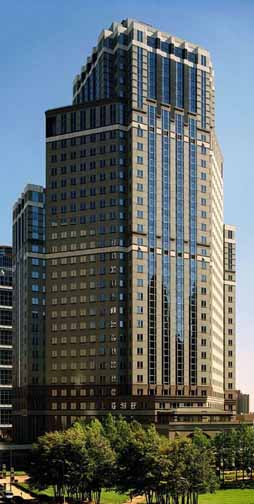
The Pla-Tyme at 622 Hennepin Ave. was at least a restaurant and the July 1944 ad doesn’t say that it had entertainment, but with a name like that, you don’t have that much fun with just steaks and chops!
Many thanks to Sara Markoe Hanson of the White Bear Lake Area Historical Society for sharing the Society’s Plantation materials with me. This turned out to be a fun project, especially with the gangster element! Two important resources used were:
Looking Back at White Bear Lake: A Pictorial History of the White Bear Lake Area, by Cynthia E. Vadnais, (provided by the WBLAHS) and
John Dillinger Slept Here: A Crooks’ Tour of Crime and Corruption in St. Paul, 1920-1936, by Paul Maccabee, Minnesota Historical Society Press, 1995
WHERE AND HOW TO GET THERE, 1930
The Plantation Night Club opened in 1930 on the shores of White Bear Lake. The current location is described as Old White Bear Avenue at Cottage Park Road.
This early ad gives some pre-freeway directions from the City:
From Minneapolis: E. Hennepin to Highway 1
From St. Paul: Highway 1 to Auto Club
1926
RAMALEY’S PAVILION
The story starts with the Ramaley family. J.D. Ramaley owned Ramley’s Pavilion at White Bear at the turn of the 20th Century.
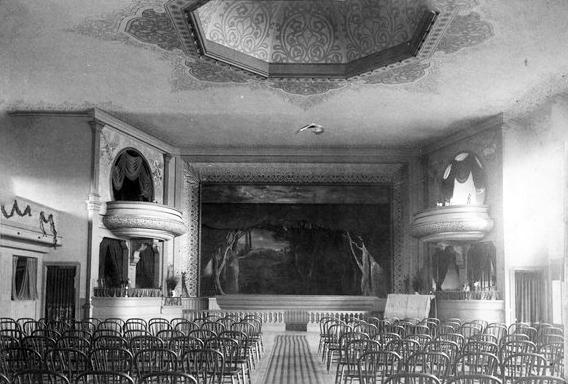
Ramaley’s Pavilion, @ 1890. Image courtesy Minnesota Historical Society
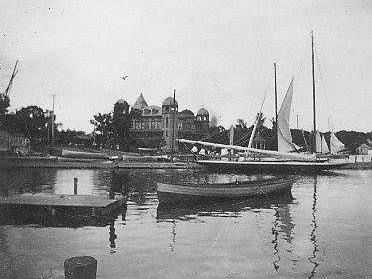
Ramaley’s Pavilion, @ 1895. Image courtesy Minnesota Historical Society
RAMALEY’S WINTER GARDEN
In 1925, J.D.’s son J.E. (Gene) Ramaley moved Ramaley’s Boat Works to Lake Minnetonka, and converted the old boat house at White Bear into a dance hall.
Later in 1925, Gene Rameley demolished the boat house and erected Ramley’s Winter Garden. The building could seat 700 and had parking for 300 cars. It cost $50,000 to build.
An article in the White Bear Press described the Winter Garden as:
a fairlylike stucco structure in Spanish style, adorned with flags and a blaze of light outside, and inside containing a spacious dancing pavilion, the fruition of a beautiful dream in which nothing even to the smallest detail has been forgotten or overlooked. The terra cotta color scheme is heightened by myriads of var-colored [sic] lights, baskets of flowers along the wall, and graceful hanging chandeliers, while the slightly arched ceiling suggest the “grand salon” of a gigantic Atlantic liner.
The popular Land of Lakes Orchestra from Wildwood [a nearby amusement park] discourses sweet music from an aerial platform accompanied by beautiful electric lighting effects. The spacious dancing floor is now as smooth as the first coat of glare ice that forms annually on the lake about Thanksgiving day. (Vadnais)
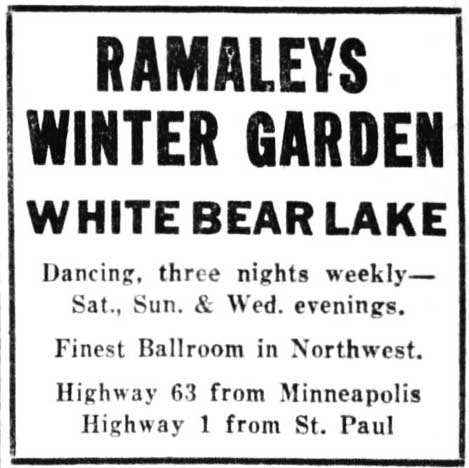
Minneapolis Tribune, November 27, 1926
1927
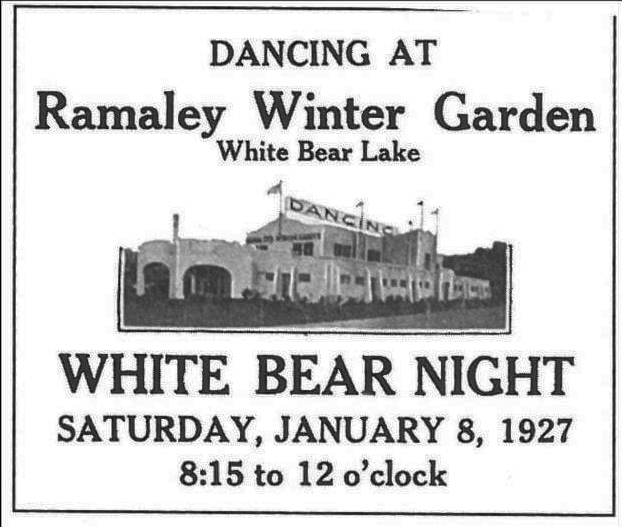
During 1927 the business was leased to two separate parties.
WMBE
The first was T.E. Barbeau, who had radio station, WMBE, hooked up so that the dance music could be broadcast. At this time only Saturday night dances were held. In 1928, the station was removed and donated to White Bear High School. (Vadnais)
An article dated May 28, 1928, indicates that this station was “the White Bear High School station,” and was cancelled by the Federal Radio Commission. The cancelled stations were in small cities or had small ranges, and were in the interest of “clearing up the radio tangle.” (Minneapolis Star)
THE NEW PERSHING INN
The New Pershing Inn opened in the building on December 3, 1927 [Thanksgiving Day, 1927]. There had been a Pershing Inn at approximately present-day Highways 100 and 394 that burned down in 1926, but other than the name, there is no indication that there is any connection. The owners were different; the New Pershing Inn in White Bear was leased by a Mr. Mendelsohn from Minneapolis.
An article, unfortunately with no date or name of newspaper, announced the change:
Winter Garden to Change to Cafe.
A deal has been consummated whereby the Ramaley Winter Garden management passes into other hands and the name is to be changed In fact the garden is to be converted into a cafe with dancing and various amusement features.
The new proprietor is Mr. H. Mendelsohn, of Minneapolis, who took charge Monday.
“It is my intention,” said Mr. Mendelsohn,” “to conduct a ten-piece orchestra, singers, dancers, and other features of entertainment…..”
Continuing, Mr. Mendelsohn stated that the name of the garden has been changed to the “New Pershing Inn.” There will be dancing Saturday night of this week, but there will be no cafe service; neither will there will be any dancing during the coming week until Thanksgiving night when the grand opening will be held. At this time, and every evening thereafter, except Monday nights, the cafe will be open and the full program carried out.
“The pavillion will be for rent on Monday nights,” said Mr. Mendelsohn, “or let on a percentage basis for charitable purposes. All other nights will be regular cafe nights. It is our intention to purchase everything we can right here in White Bear and to boost all we can for the city, and trust we will have the good will and support of the people of this city.”
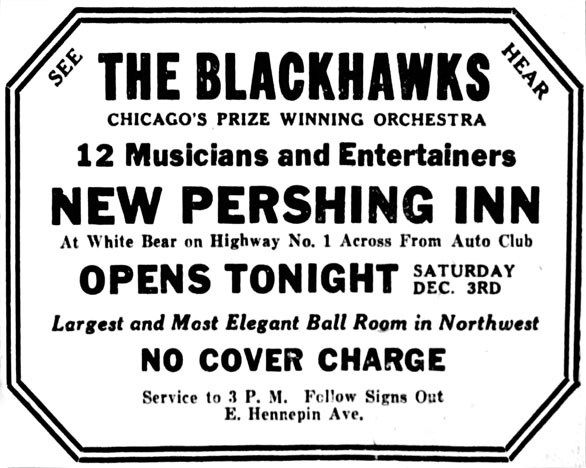
Minneapolis Tribune, December 3, 1927
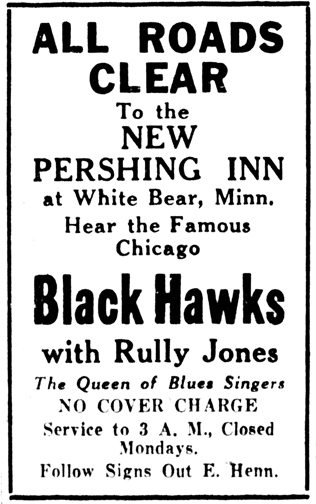
Minneapolis Tribune, December 11, 1927
Ads for the New Pershing Inn only appeared in Minneapolis papers during the month of December 1927.
Ramaley was once again the manager before the end of the year. (Vadnais)
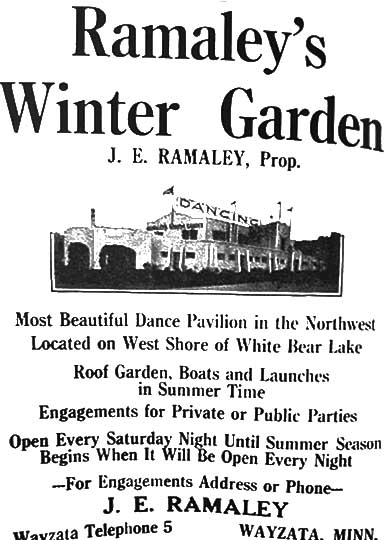
1927 ad from White Bear Press; Image courtesy White Bear Lake Area Historical Society (Vadnais)
1928
WHITE BEAR CASTLE
In 1928, there were two ads in the Minneapolis papers for the White Bear Castle. Larry Johnson was the manager. The ad below cites Walt Anderson and His Original Golden Pheasant Cafe Band. The Golden Pheasant was a Downtown Minneapolis Chinese restaurant with a checkered reputation. In 1927, the band was called Walt Anderson and His Hoodlums…
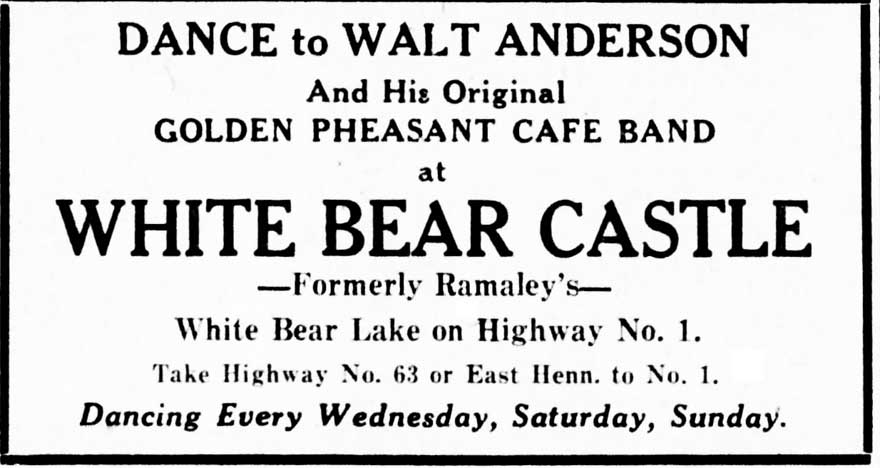
Minneapolis Tribune, May 26, 1928
The White Bear Press published at least two other ads for the White Bear Castle in 1928 – dates unknown. (Vadnais)
1929
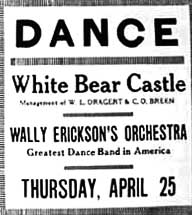
White Bear Press, 1929. Image courtesy White Bear Lake Area Historical Society (Vadnais)
On May 8, 1929, Ramaley advertised to rent the building for “dance, dine.” (Minneapolis Tribune)
1930
THE PLANTATION NITE CLUB
The Plantation “Formerly” (sic) opened on Wednesday, July 2, 1930, at 9 o’clock, announced an article in some unidentified newspaper (presumably the White Bear Press). The first night was an invitation-only premier party. Manager Ben Harris would be the proprietor during the entire run of the club.
$10,000 had been spent to make the place look like a plantation:
Beautiful trees spread their branches, forming a canopy, and creating a bower of foliage. The check room is a splendid replica of an old shed, in one corner of the plantation. (White Bear Press)
From information below about the gangsters and their activities, one would speculate that part of that $10,000 went into building a casino with a separate entrance that could be guarded and monitored.
KSTP radio was connected and the music broadcast for half an hour each evening, five days a week. (Vadnais)
Below is the photo of the club that accompanied the initial article. Keep an eye on the sign on top of the building. It did not originally have the scaffolding that it had later on.
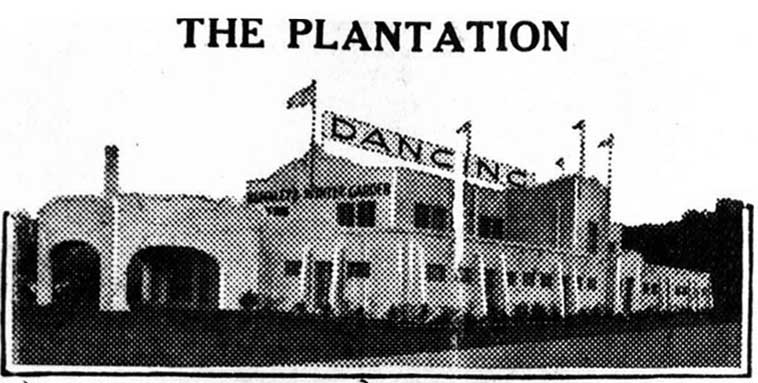
Image courtesy White Bear Lake Area Historical Society
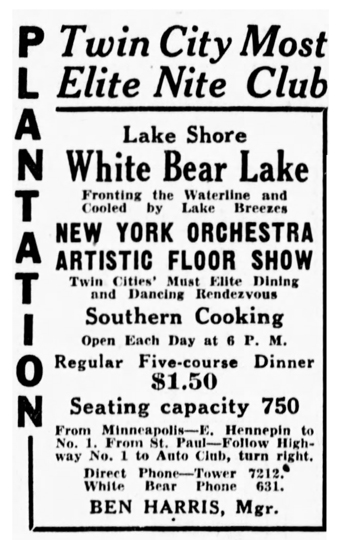
Minneapolis Star, August 7, 1930
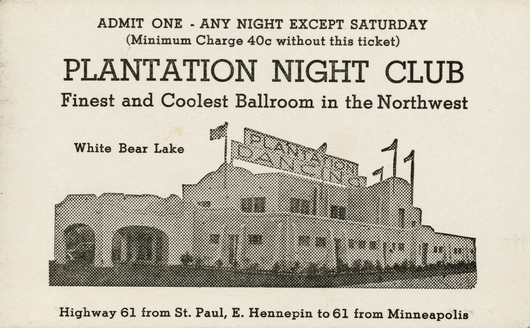
Undated ticket – image courtesy Minnesota Historical Society
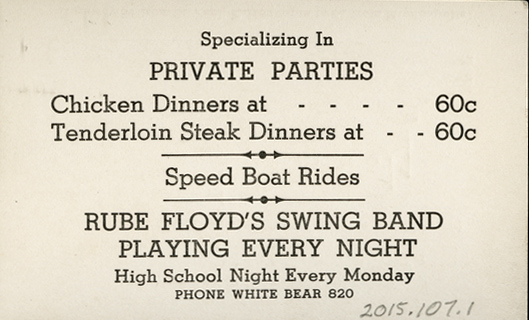
Undated ticket back – image courtesy Minnesota Historical Society
1931
The 1931 season opened on June 16.
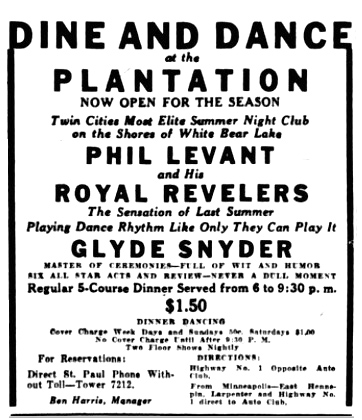
Minneapolis Journal, June 1931
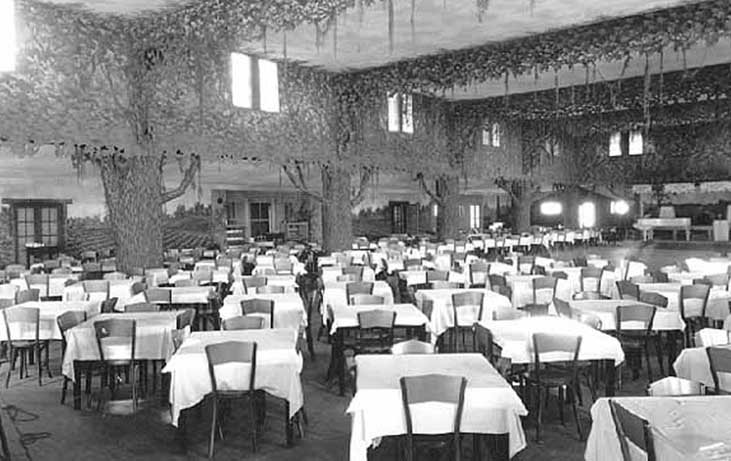
Minneapolis Journal, June 1, 1931; Image courtesy White Bear Lake Area Historical Society
GANGSTERS AT THE PLANTATION
The Plantation was run by Ben Harris, a Minneapolis gambling figure that the FBI claimed “was directly connected with the Barker-Karpis gang, and with practically all of the well-known crooks in Minneapolis and St. Paul during the prohibition days.” Harris told the FBI that he actually had a partner, John Lane, owner of the Boulevards of Paris night club.
Robert “Frisco Dutch” Steinhardt acted as a bouncer and gambling consultant at the casino he and Bob Hamilton opened. Dutch was a friend of the Barker-Karpis and Keating-Holden gangs, had participated in the famous Willmar bank robbery, and had been arrested 18 times for various petty crimes. In 1932 Steinhardt ran the gambling at the Plantation for 60 percent of the proceeds.
Other patrons during the summers of 1931 and 1932 were local fixer Jack Peifer and bootlegger Morris Roisner, bank robbers Jimmy Keating and Tommy olden, and Capone gunman Fred Goetz. Despite reported sightings, Capone himself preferred to vacation in Wisconsin. Frank Nash, a visiting gangster from Oklahoma in 1931, reportedly won $6,000 in one night of gambling. But all was not rosy for Nash – he could not go swimming in the beautiful White Bear Lake because of his toupee.
Strength in numbers made local and even national gangsters of the era comfortable in White Bear Lake, renting cottages for the summer and using the Plantation for their headquarters. This infuriated FBI Chief J. Edgar Hoover. “With ready money and confidence in their power,” said an official FBI summary, the gangs “relaxed vigilance and indulged in riotous nightlife” in White Bear Lake. (Maccabee, pages 96 – 98)
It has been said that armed guards with Tommy guns stood outside the entrance to the gambling casino. (Vadnais)
Oh, and about liquor, Prohibition lasted between 1920 and 1933. No liquor was served during that time, but the club did provide set-ups and people brought their own bootlegged hooch of choice. (Vadnais)
1932
The 1932 season opened on June 15.
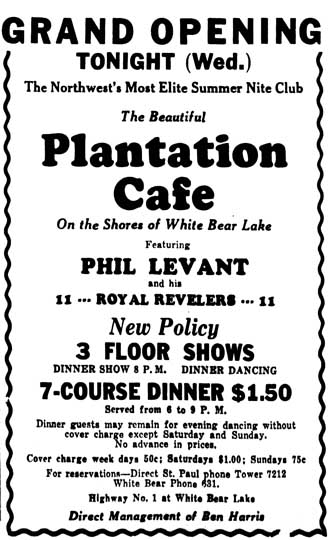
Minneapolis Tribune, June 15, 1932
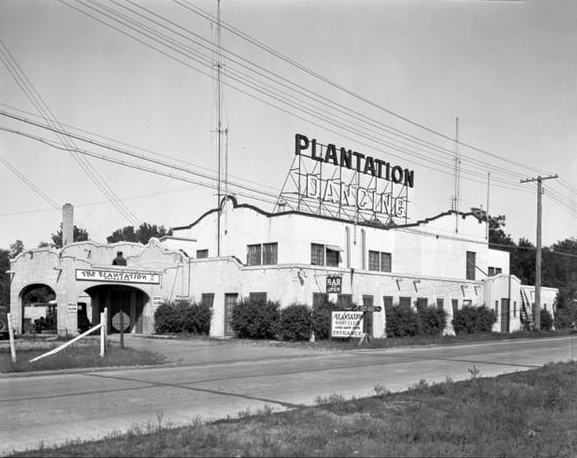
Undated (1930s) photo courtesy Minnesota Historical Society
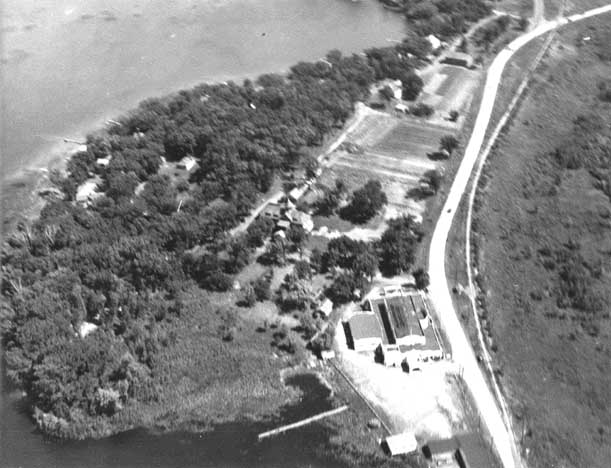
Aerial (looking south) of the Plantation, taken in 1932. Image courtesy White Bear Lake Area Historical Society
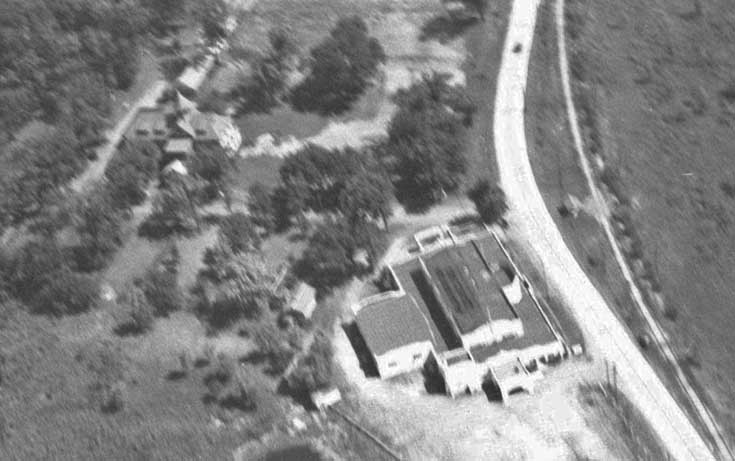
Closer (but fuzzier) shot of above aerial. Image courtesy White Bear Lake Area Historical Society
1933
Beer became legal on April 7, 1933, and the harder stuff according to local law. Bootlegging became less profitable, and the Depression put a dent in people’s spending cash.
Opening day for the 1933 season was June 7, and an article (presumably from the White Bear Press) dated June 2, 1933, described the amount of work the building needed after standing empty for nine months. Repairs were needed to the roof, floor, and ceiling – the latter decorated as the sky. Real southern moss was hung from the trees and a cooling system was added.
Joe (Coon) Sanders was the big act on the bill, said to be the first in America to entertain on the radio. Each night there would be three floor shows with stars such as singers Rick and Snyder; dance team the Texas Redheads; and acrobatic dancer Bebe Belmore. Patrons were served a seven-course dinner, and there was no cover charge.
Below is the ad from opening day, 1933.
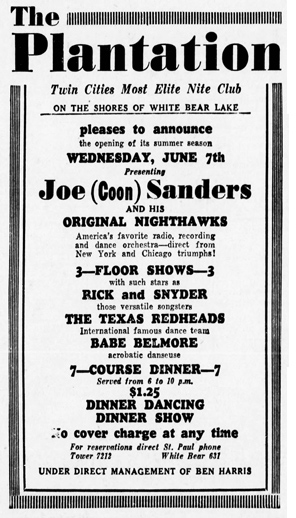
Minneapolis Star, June 7, 1933
A follow-up article dated June 9, 1933, reports that over 800 people came to the opening of the Plantation, with patrons coming as far as Stillwater, Hudson, Northfield, St. Cloud, and Fargo, Ben Harris’s home town. A storm turned off the lights for about 20 minutes, but candles made for “a quite pleasing effect.” All of the acts were well received, the article reported, and the orchestra members and artists “are making a scramble for cottages here for the summer.” “Red” Hyland was again the house manager. Little “George” – the colored door man – who has heretofore been a red bird, has changed his habit to blue – a blue-bird for happiness, seems if. (presumably White Bear Press)
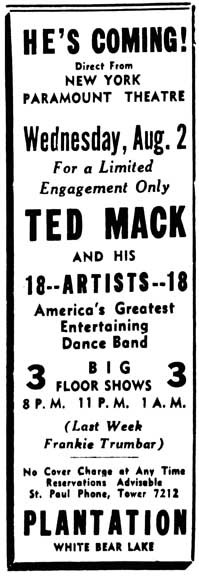
Minneapolis Tribune, July 30, 1933
Ben Harris closed the Plantation at the end of the 1933 season. He said, “In 1930 and ’31 I did well, but the Depression hit everybody so hard they couldn’t keep up their patronage. 1932 was hard but 1933 was worse.” (Vadnais)
1934
On March 30, 1934, the Ramsey County sheriffs were apparently trying to clean up the area. On that day they held warrants for “Bennie Harris,” described as former proprietor of the Plantation Night Club, for maintaining gambling devices. (Minneapolis Tribune, March 31, 1934) Harris pled guilty to running a roulette wheel and was given 90 days in the workhouse. (Minneapolis Star, April 6, 1934) The sentence was later cut to 30 days and he was allowed to serve it in the county jail instead of the workhouse, all for his convenience since he ran a liquor store by the St. Paul courthouse at the time. (Minneapolis Star, April 21, 1934) In August 1934, Harris went on to manage the new 620 Club in Downtown Minneapolis and many other bars.
1935
In 1935, Ramaley decided to reopen the Plantation. The bill of fare was a wholesome, all-family-members-allowed barn dance at a bargain admission price of 35 cents. The club wass to be open six nights a week with four different orchestras performing each week. WTCN was the radio station that broadcast the dance music. (Vadnais)
On May 17, 1935, the WCCO Barndance performed at the Plantation. 25 performers came to present a live radio show. (White Bear Press ad courtesy Vadnais)
1937
The Plantation opened on June 16, 1937. “Under Same Management.” (White Bear Press ad courtesy Vadnais)
1939
Management was apparently renting the building out to groups for dances, as evidenced by an article in the St. Paul Recorder that advertised a “big cabaret dance” on October 9, 1939, sponsored by the Cameo Social Club. Rube Floyd and his swing band would provide the music. The public was invited. The St. Paul Recorder was the City’s weekly newspaper for the black community. Social clubs would often find venues to hold dances, since most clubs in town were not integrated. The term “cabaret dance” is seen quite often, but I don’t know what it entails. (St. Paul Recorder, October 6, 1939)
1941
Another big dance advertised in the St. Paul Recorder took place on Monday, July 21, 1941. Les Hite and his orchestra presented stars such as Oscar Bradley, the world’s fasted drummer; Qudy Martin, ace tenor and clarinetist; Smokey Joe, second only to Jimmie Rushing; and Hite’s famous Swinging Glee Club. An added attraction was that the winners of the Negro Open Golf Tourney were to receive their prizes at the affair. Also, the article said that “this will be the First public dance the Twin Cities dancing public has ever had at the beautiful Plantation Nite Club.” (Notwithstanding the 1939 event.) Contacts for making reservations were Vernon Barksdale or L. Garrett. (St. Paul Recorder, July 18, 1941)
A follow-up article in the next week’s Recorder called the Hite dance “one of the most orderly and largest dance crowds of the year” and named Levi Garrett as the promoter. Most of the rest of the article was kind of gossip column, naming popular party-goers. (St. Paul Recorder, July 25, 1941)
PLANTATION BALLROOM?
The ad below calls the place the Plantation Ballroom. Did it change it’s name? It’s image, perhaps?
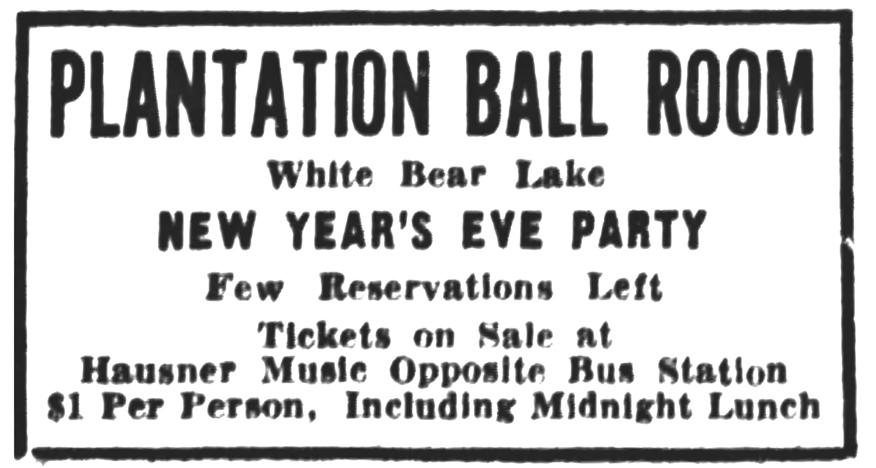
Minneapolis Star, December 21, 1941
1942
Expectations may have been to continue the operation of the Plantation into 1942, as evidenced by the ad below, opening the building at the end of May.
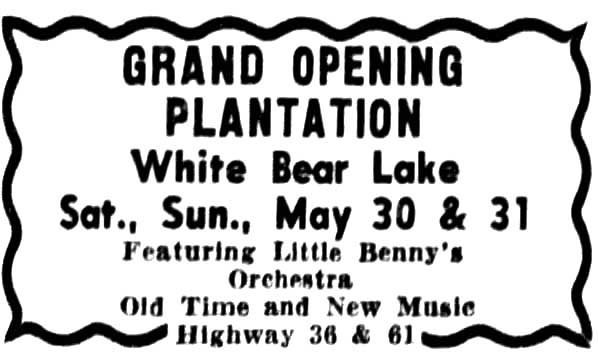
Minneapolis Star, May 25, 1942
A dance was held by the Onyx Club at the Plantation Nite Club on May 29, 1942, according to Inquisitive Sal (Helen M. Scott), Social reporter of the St. Paul Recorder. The Omega Psi Phi Fraternity was holding their spring prom the same night, and Sal suspected that after the prom, many of the attendees would dash out to the Plantation (and the wonderfully-named Stumble Inn) for after parties. (St. Paul Recorder, May 29, 1942)
The next issue of the Recorder reported that a severe storm spoiled the party, and it was announced that it would be rescheduled for Friday, June 12. Soldiers in uniform would be admitted for free. Rook Ganz’ “fine cabaret” will entertain the patrons. (St. Paul Recorder, June 5, 1942)
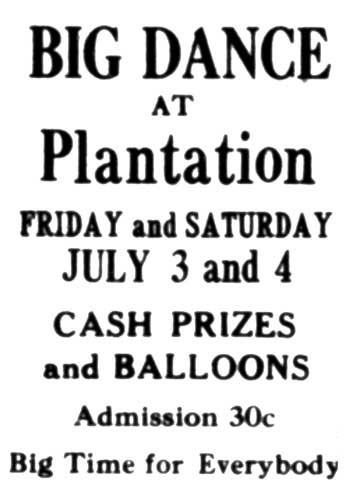
July 3, 1942 ad courtesy White Bear Lake Area Historical Society
It has been reported that the building went dark during World War II. The few dances in 1942 above may have been the last uses of the building as a dance hall.
1946
THE PLANTATION PLAYHOUSE
In 1946, three former service men, Kenneth and David Raskin, and Allen Livers wanted to transform the old building into what would become the Plantation Playhouse. This was at just the time that the Aulger Brothers Tent Shows, active since 1899, went out of business. Aulger sold his equipment, including 400 auditorium seats, for their new theater. (Minneapolis Star-Journal, Virginia Safford column, May 20, 1946)
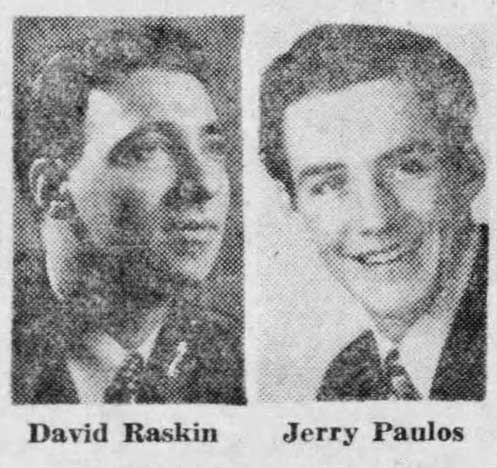
Minneapolis Tribune, September 22, 1946
The first play presented was “The Hasty Heart,” starting June 19, 1946.
Below is an early program.
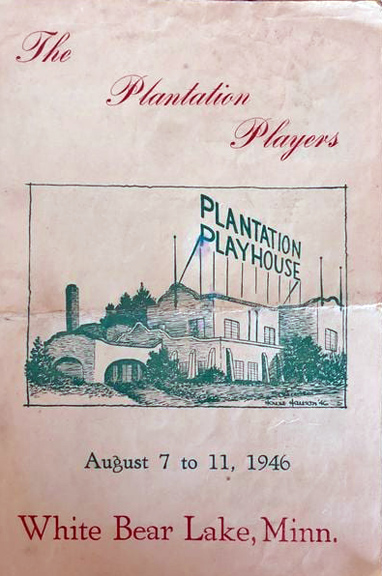
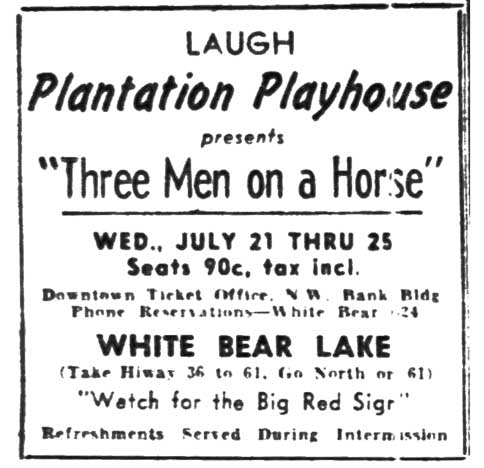
Minneapolis Tribune, July 18, 1948
Plays were performed by University of Minnesota students on shoestring budgets. The playhouse lasted for at least three seasons.
1951
The building stood vacant in 1949. In 1950, Arthur Allen purchased the building and razed most of the main structure. The building was remodeled into a building shaped like a boat. The Plantation Boat Livery & Drive-In opened for business on May 12, 1951. Allen had purchased boats for hire from Amundson Boat Works, and with his family successfully operated the business until about 1959. (Vadnais)
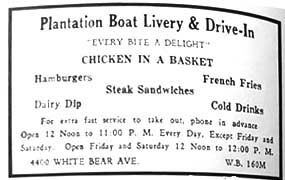
1954 ad from White Bear Press. Image courtesy White Bear Lake Area Historical Society
END OF THE PLANTATION
The City of White Bear Lake purchased what was left of the building on May 31, 1974. It was finally razed in June 1974. In its place is Lion’s Club Park, with the address of 4410 Lake Ave. So.
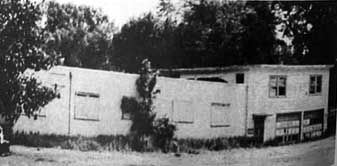
Plantation, 1974. Photo by White Bear Press; Image courtesy White Bear Lake Area Historical Society (Vadnais)
1972 seemed to be the apogee of porn – or at least the kind you did in public, like massage parlors, saunas, lingerie shows, places where women tickle you with feathers, and dancers without tops and/or bottoms. A surprising number of the latter turned out to be married women with children, if you believe the papers. A lot of these places were advertised in magazines that were, on the surface, supposed to tell hotel visitors what to watch on TV, but were packed with ads for places much more interesting to watch.
And so we have the Play Pen, which I can’t really do a newspaper search for, but came across in the personals announcing the Grand Opening on November 2, 1972. “St. Paul’s newest club, exotic dancers. See it all at the Play Pen, Smith and 7th.”
This soon got out of hand and on the last nerve of City Councils everywhere, so eventually these places went away or were replaced by strip clubs with strict rules.
And now we have the internet, so we can do our peeping in private.
There you have a very perfunctory history lesson.
The Plaza was a piano bar located at 2431 W. Seventh Street in St. Paul. Ron Lovich, who posted the matchbook below, reports that it was owned by his two uncles and a friend from 1958 to 1973.
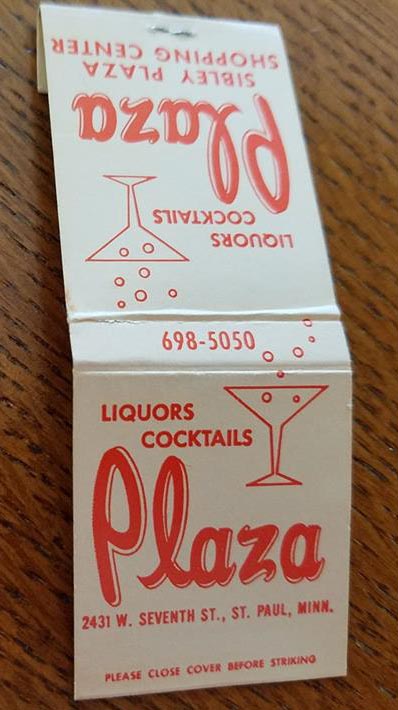
In 1973 it was sold to Vern Lauderville, who expanded it and changed its name to the Concourse. He also put in a window so customers could get food from the Best Steak House next door.
Ron reports that the location later became the first Champps.
The Point was located at 7711 Golden Valley Road. “The Point” in Golden Valley was the junction of 19th and Sixth Avenues North.
The Point Supper Club opened in 1956 as a jazz venue by Larry Hork.
1963: Dine and dance in an attractive setting. Sing along in the Top O’ the Point piano lounge.
The Point burned down on October 18, 1973. Percy Hughes’ Orchestra was the house band from 1957 until the fire.
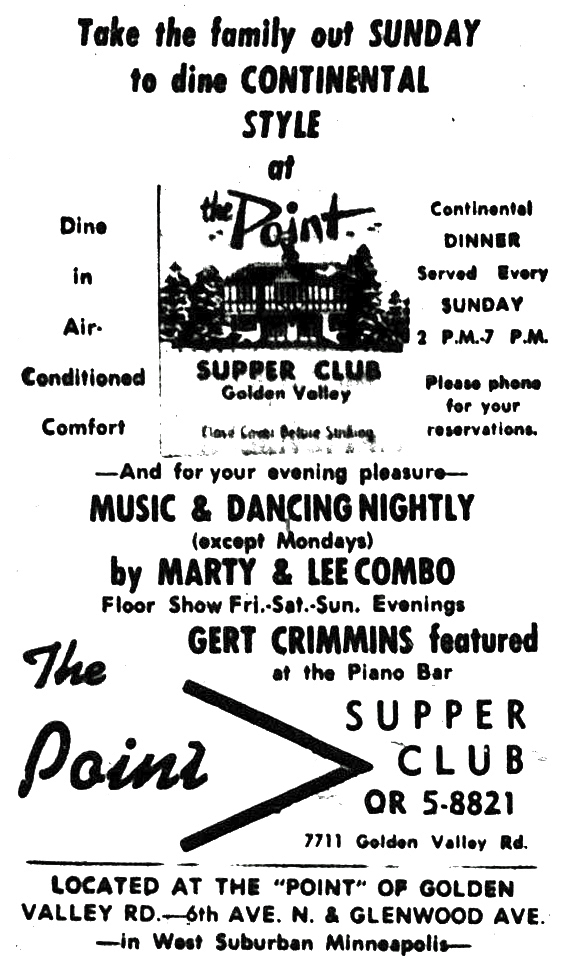
Ad from 1971
Save
The Poodle Club was located at 810 Hennepin Ave. in Downtown Minneapolis, on the ground floor of the Anthony Hotel.
THE BUILDING
This building, located across from the State Theater, was built at the end of 1886 as the Holmes Hotel. It stood vacant for the first two years. In 1911 it became known as the Elgin Hotel. It was purchased by a local hotel operator in 1945. The name seemed to disappear, but by 1949 it was the Anthony Hotel – the name it kept until it burned down.
From sketches it appears that there were three storefronts to the building.
DOC’S SPORTSMAN’S CLUB
This was a bar, at the least – not sure if there was entertainment. In September 1936 a man dressed in riding breeches was accused of “mashing” when he accosted a female employee of the bar while she was on her way home.
ANDY’S BAR
Andrew “Andy” Leonard had a series of venues downtown.
Club Lido: 1935
Andy Leonard’s: 1941 – 1945
Andy’s Bar opened in 1949 at 808-810 Hennepin Ave., operated by James J. Dreis and Frank S. Leonard, probably a relative of the bar’s namesake, Andrew “Andy” Leonard. Andy was said to have been involved in running it.
In February 1954 Andy applied to take over the license. This may have been because Frank was indicted on two counts of watering down 11 bottles of Corby’s and Seagram’s 7-Crown. Frank plead guilty and was fined $250 and given two years probation. But then in October 1954, Andy’s Bar’s liquor license was transferred to the Leamington Hotel.
In November 1954 it was the Leamington that put the fixtures of Andy’s Bar up for sale, including a horseshoe bar, 54 stools, 12 booths and tables.
Andy died on February 24, 1963.
THE POODLE
1960
In 1960 the liquor license of Carl Blumenthal at the 114 Club at 114 S. Washington Ave., was transferred to 810 Hennepin in 1960. The 114 Club was a victim of Skid Row redevelopment.
The Poodle started out with a French theme, and its entertainment was strictly jazz.
Here are two items in a row in Will Jones’s column in 1960:
Dale Olinger, sometime guitarist with the Herb Pilhofer Trio, has organized his own trio to provide quietly swinging sounds in a brand-new saloon at 810 Hennepin.
The Poodle, next door to Jean’s French restaurant, continues the French theme with a gaslighted garden setting. The operations are separate, but a door connects the two places. After licensing technicalities are straightened out, the Poodle will be able to serve its customers food from Jean’s, and Jean’s, now liquorless, will be able to send next door for wines and such.
1961
In 1961, Will Jones reported that:
To spice up Tuesday nights, the Poodle has initiated Monmartre night. Waitresses get out of their skimpy Playboy-style costumes and into Apache dancer skirts and berets. The bartenders wear false mustaches and berets. There’s black bread and French cheese for snacking. (Minneapolis Tribune, April 7, 1961)
1963
Hi-Fi Jazz may have been the playing of records – a 1963 version of jazz disco.
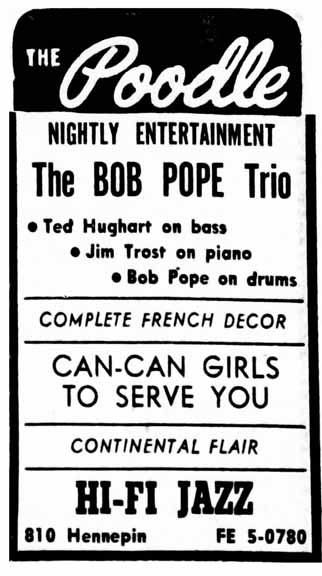
Minneapolis Star, July 11, 1963
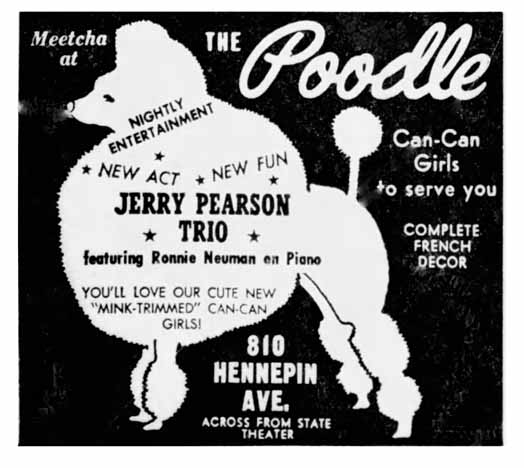
Minneapolis Star, November 14, 1963
The Jerry Pearson Trio was the house entertainment through June 1965; various singers were featured.
1964
In December 1964, Will Jones was particularly taken with featured singer Carol Robins, who reminded him of Barbra Streisand, only not really. Excerpt:
She’s dark, chunky, and cheerfully mean-looking and when she sings “Bill Bailey, Won’t You Please Come Home” she does it with a sly malevolence that suggests Bill should come on home, all right if he thinks he can stand it.
1966
In March 1966, the Poodle underwent a major expansion. Will Jones explained that management was taking over the property next door, last occupied by the defunct Shish-ke-Bab Restaurant, and turning it into a separate room for dining and dancing.
“We’re not going to change a thing in our present place, because it’s too successful,” said operator Harold “Pat” Blumenthal. “And, in the new place, we’re NOT going to have a go-go room.” (Minneapolis Tribune, March 28, 1966)
In June 1966, a half page ad announced that you could get a steak dinner, dancing, and entertainment at the Poodle for under $2! No Gimmick! The Poodle had been newly remodeled and expanded, adding twice the area for dining, enlarging the dance floor, and completely remodeling the interior and exterior. Best of all was the new menu, featuring an 8 ounce US Choice Tenderloin Steak Dinner for $1.95. “Or you can really live it up with a 14 ounce US Choice New York Cut Sirloin Steak for $2.95.
Appearing was the Jerry Pearson Trio, featuring TV and recording star Tommy DeNoble with his swinging vocals. (Minneapolis Tribune, June 21, 1966)
The ad below is from the following September, when the Trio had become a Quartet and Tommy had been replaced by Jeannie Farrell. Apparently the restaurant was called the Sidewalk Cafe.
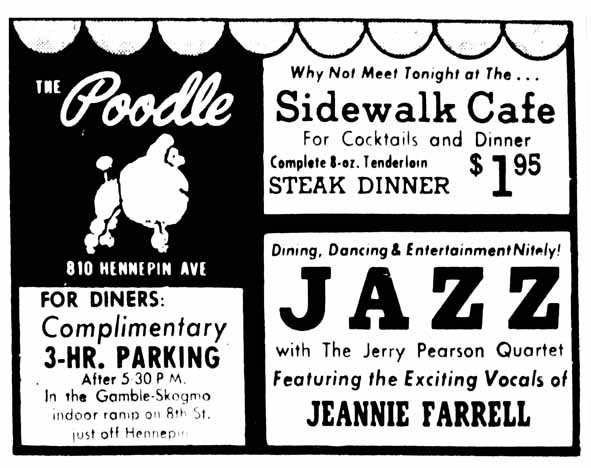
Minneapolis Star, September 22, 1966
1967
Comedian Danny Klayman was added to the entertainment lineup in January 1967; the Jerry Pearson Quartet was still the house combo.
But finally in mid- 1967 the Poodle appeared to get into rock and blues; somehow jazz never lasts.
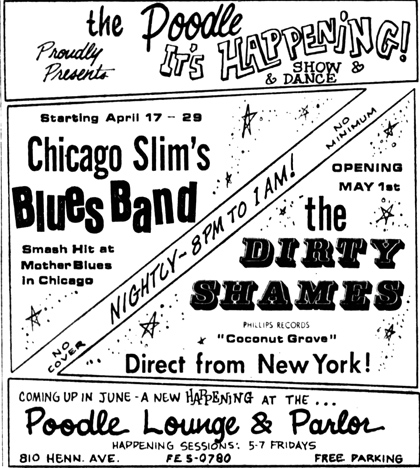
Minneapolis Star, April 19, 1967
May 1967: the new breed featuring Jerry Cole
June – October 1967: The Untouchables featuring Carrol Bateman
October – December 1967: Tiny’s Trio Plus 1
1968
January – October 1968’s House Band was the Starliners, alternately headed by John Fritz, Jack Kollodge, and Keith Zeller. Sock it to me!
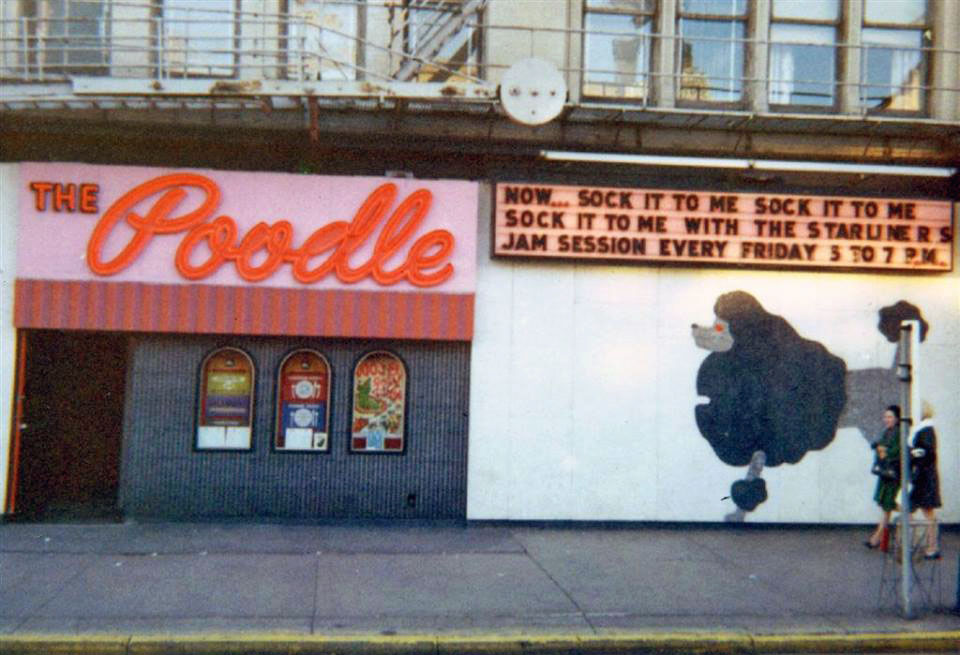
1968 Photo courtesy Minniepaulmusic.com
In November 1968, Transplant took a turn at the entertainment.
1969
The Transplants (or Transplant, as written in the calendar of events) was the house band through the entire year of 1969.
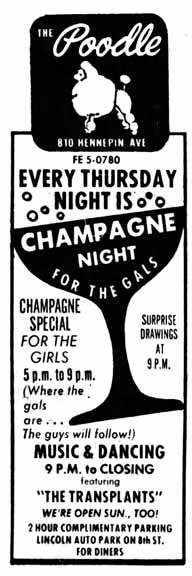
Minneapolis Star, January 29, 1969
Pat and his father Carl Blumenthal bought the Anthony Hotel, which included the club, in 1969.
THE ATTIC
In December 1969, the Poodle unveiled a new piano bar called the Attic, aptly named because one had to climb a long, steep flight of stairs to get there, according to Will Jones. Early entertainers were Ronnie Neuman on the piano and percussionist Roman Gomez. Words of old songs were flashed on the wall via slides so people could sing along. The Attic was furnished with “genuine attic junk” that owner Pat Blumenthal had found in the Anthony Hotel that he had just bought (and where the Poodle was located). Blumenthal also found furnishings from his own attic, and the Salvation Army and Goodwill stores. Jones recommended going later in the evening, when the musicians did their own thing for listening. (Minneapolis Tribune, December 13, 1969)
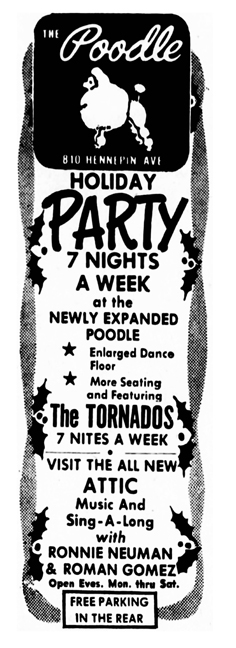
Minneapolis Star, December 15, 1969
The Tornados had the gig from December 1969 to February 1970.
1970
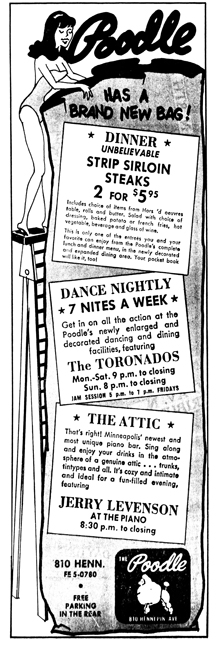
Minneapolis Star, February 5, 1970
May – September 1970: Hope
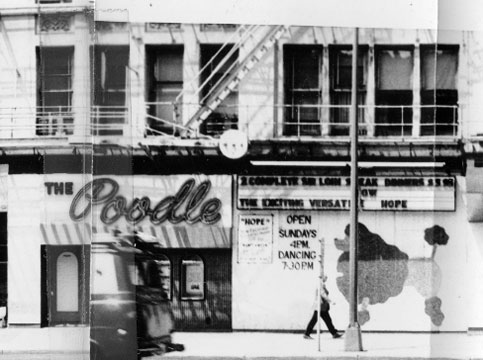
1970
On December 5, 1970, photographer Mike Barich took a trip to the Poodle to take some photos for the Insider magazine.
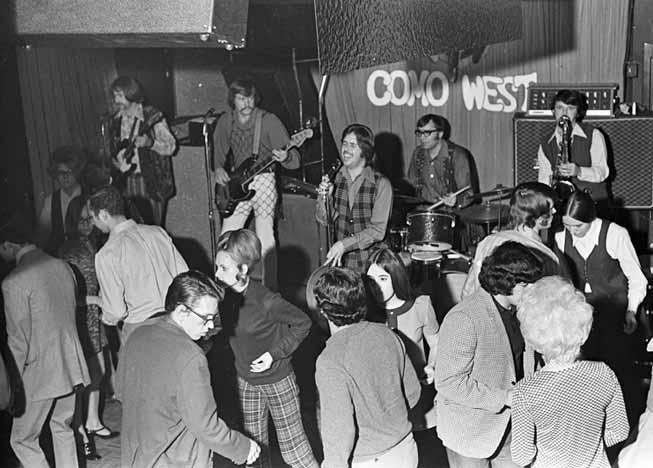
Como West on the main level. Photo copyright Mike Barich
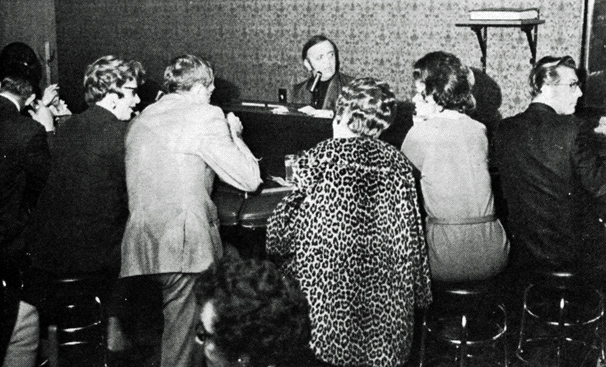
George Griak at the piano bar in the upstairs Attic. Photo copyright Mike Barich
1971
Como West and George Griak continued into at least August 1971.
GAY DANCE-IN AT THE POODLE
On December 30, 1971, about 30 homosexuals held a “congenial dance-in” at the Poodle to protest discrimination against gays at the club. The protest was sparked when two 22-year-old married women who were dancing with each other were forcibly removed from the dance floor the previous Monday.
The protest began when the participants arrived at about 10 pm and began dancing with members of the opposite sex for about 20 minutes. Then they paired off by gender to dance to the rock band. There was no attempt to stop them, and the participants cheered and applauded when the song ended.
The Star reported:
“I think it’s a first step,” said Steve Endean, 23, and organizer for Gay Political Activists. “They got over the idea of ‘separate but equal’ for blacks, he said. “It’s high time they did for gays.”
Dave Christian, a worker at Gay House, commented that, “We’re not trying to be obstreperous or anything. We’re just trying to see that people are decent.”
And Jim Johnson, who was managing the bar last night, said he was agreeable to the protest. “What do I care?” he said. “Otherwise we’d have had a quiet night.” He said he wasn’t there when the women allegedly had been removed and didn’t know what had happened.
The women were named, and their hair color and dress lengths were described. They said they had been coming to the bar and dancing with each other for a couple of months before the incident. One said they had been accused of doing an “obscene” dance, even though they were several feet apart on the dance floor. “The way some of these dudes (male customers) dance is a lot more obscene than anything we were doing,” she said. (Jim Talle, Minneapolis Star, December 31, 1971)
1972
The text below this ad reads:
The Reasons have just started an unlimited engagement at the Poodle, 7 nights a week from 9 – 1. The new, new, Reasons have been together for about four months. The group consists of 7 pieces with a strong horn orientation and features the music of Ball n’ Jack, Savoy Brown, Cocker, Chicago,Santana, BS&T, as well as original compositions.
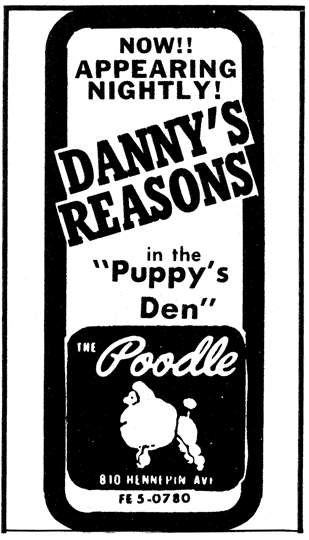
Insider, February 1972
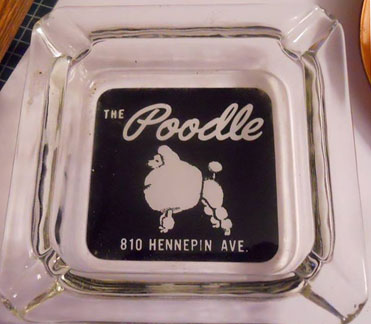
From the collection of Mark Youngblood
Matchbook below left (boasting “Frosted Cocktails”) from the collection of Scott Bottolene. Inside of matchbook from the collection of Mark Youngblood.

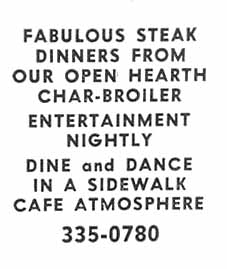
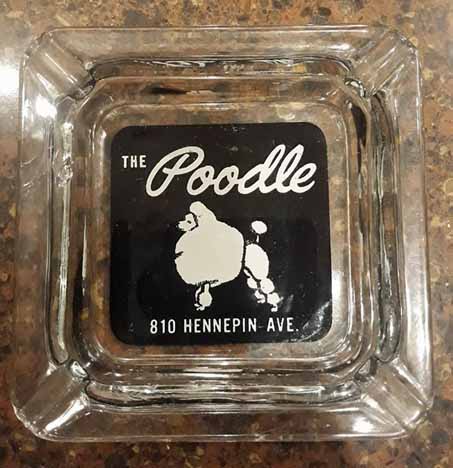
Another ashtray from William Kuether
1973
THE END OF THE FIRST POODLE
The Anthony Hotel, including the Poodle, burned down on December 20, 1973. Subzero temperatures turned the six-story building into one big icicle. The fire took three hours to put out. 75 people were registered in the hotel, and although the Fire Chief said “We expect to find some bodies,” there were no deaths. The Red Cross provided rooms for 36 people who lived at the hotel. Five people, including two firemen, were treated for injuries.
“The fire quickly reached the roof and bright yellow flames sent embers into the air that dropped into the streets and onto the crowd below,” reported the Star. Firemen were soon driven from the building by the flames. They tried to hose the roof from a ladder but the ladder was too short by several feet. They finally took hoses to the top of the adjacent Lincoln Bank Building.
The loss was estimated at $750,000. (Minneapolis Star, December 20, 1973)
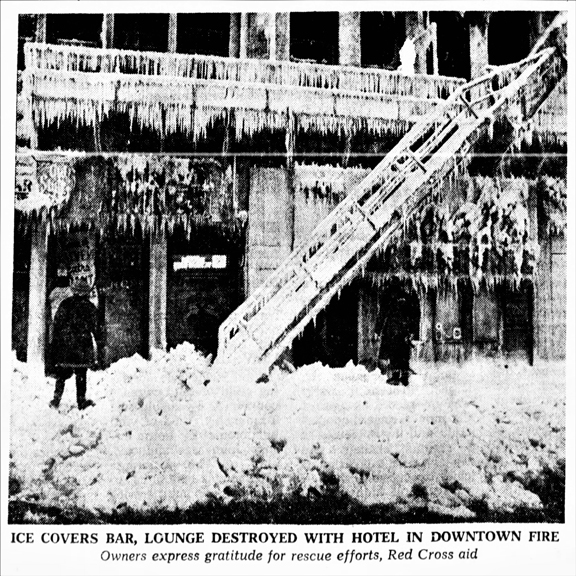
Minneapolis Star, January 5, 1974
1974
THE NEW POODLE
The building on Hennepin was demolished in January 1974 and the Poodle was relocated to 3001 E. Lake Street. In 2010, the new location, by then called McMahon’s Pub, suffered a devastating fire that killed six people in the building, also owned by Blumenthal.
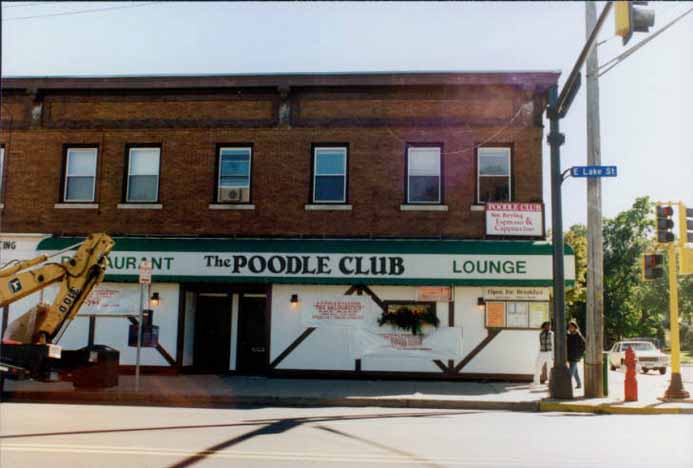
1997 photo courtesy Hennepin County Library
THE MUSIC ROOM
On June 28, 1974, Pat Blumenthal opened The Music Room, a jazz night club, at 14 S. Fifth Street, over the Longhorn Restaurant.
Nicollet Ave. between Lake and 31st, east side. As noted on the ashtray below, “opposite the ballpark,” the ballpark being the old Nicollet Baseball Park, home of the Minneapolis Millers. Used to have the only liquor license south of Lake Street.
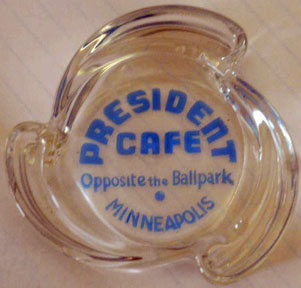
Ashtray from the collection of Mark Youngblood.
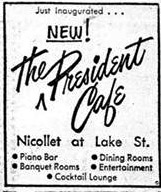
Tribune ad, October 14, 1965
The Prince of Wales Inn was located on the north shore of Lake Johanna in 1940. Operated by Eddie Guth – Be entertained by Eddie and His Music.
The Prison was located on Highway 13 between Cedar and Lyndale Avenues, or “one mile east of the Lucky Twin Drive-in on Highway 13” in Burnsville.
It opened in 1968 and had two stages at opposite end of the floor. The owner was Pat Raines, who later moved to Los Angeles and became the manager of Al Jarreau.
It appears that the audience sat on the floor for performances.
Arlo Hennings says there was a soda fountain with table and chairs. “Pat Raines built an area surrounded by wooden bars and I painted them purple to apparently resemble a prison!”
LOCAL ACTS
The Blues Cube, formerly Marcia and the Lynchmen, played their final gig at the Prison on August 24, 1968.
Big Daddy Wags Night was at the Prison on July 19th, 1969. He brought the Voxmobile. Bands participating included
- The 19th Amendment
- Bananas
- Pure Honey
- Pride & Joy
- Olivers
- Pepper Fog
- CA Quintet
- Stone Hedge
- Boiling Point
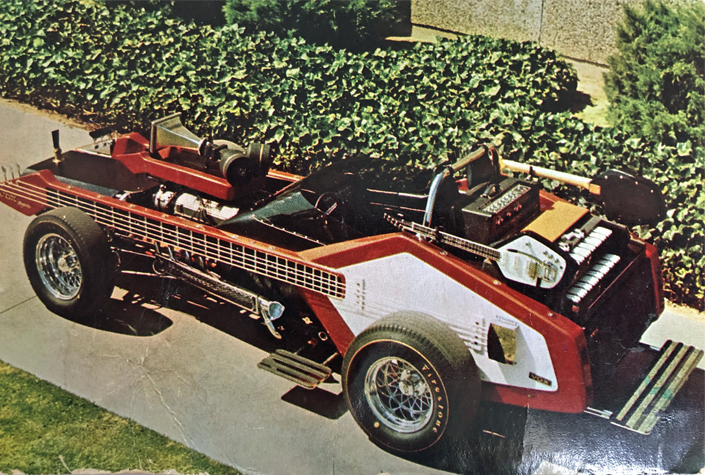
Photo of Voxmobile courtesy Dennis Libby
Bruce Glewwe:
I went to the Prison a number of times. There was a band there I think called Show Time. Their sets would start with the white guys playing probably a Temptations song and then the “cool” black guys would stroll in and join the band and sing a dance song that would fill the floor.
WHITE LIGHTNING
White Lightning appeared on March 7, 1970, and the performance was caught by photographer Mike Barich. The photos show a rather bleak, truly prison-like room, with the audience sitting on the floor.
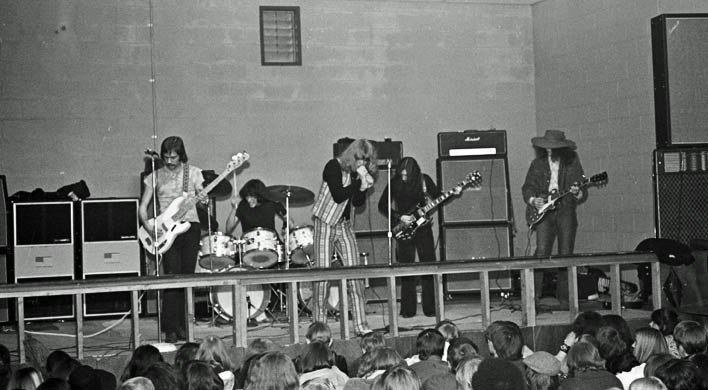
White Lightning. Photo copyright Mike Barich, St. Paul
Underneath all of the flowing locks are Woody Woodrich, bass; Bernie Pershey, drums; Mickey Stanhope, vocals; Zippy Caplan, guitar; Ronn Roberts; Guitar. (Thank you, Janet Deane!)
NATIONAL ACTS
The Prison hosted some big time national acts during its lifetime, including:
Three Dog Night on July 9, 1969.
The Buckinghams on August 9, 1969.
Lee Michaels and the Mystics on August 30, 1969.
Buddy Miles Express on October 10 and 11, 1969.
JOE COCKER
Joe Cocker braved a snowstorm to perform on December 14, 1969, his last appearance in the US before returning to England. Danny’s Reasons opened the show.
Tom Barbeau reports:
There couldn’t have been more than 200 – 300 hundred people there. That was a small crowd in that room, as I recall a lot of empty space. My group of 6 or 7 guys who made the trip (packed into a ’53 Ford coming from St. Paul, through a snow storm), had no trouble getting to within 20 to 30 feet of the stage with lots and lots of empty space behind us. Everything he had at Woodstock the previous August, he showed us there, that night, and the crowd was totally blown away.
At that time Cocker had four singles on the charts, none in the top 20. Tom indicated that he was relatively unknown at the time. Although he had made a star-making appearance at Woodstock, the film Woodstock wouldn’t be released until 1970.
Turtles on January 24, 1970.
Mark of Zorro on March 7, 1970. Local group?
An unknown Norman Greenbaum appeared to a small crowd on April 25, 1970. There were conflicting accounts of the venue for this appearance, so I took a chance and emailed Mr. Greenbaum, and he responded! He did remember making an appearance in the Twin Cities, but unfortunately didn’t remember where he performed. I must have found further evidence that he was at the Prison.
The Hollies appeared on April 26, 1970.
A 1970 ad said “Break into the Prison – Home of the Most Exciting Bands in the Twin Cities. Dance up a Storm with No Guards in Towers. Action every Friday – Saturday.”
Save
The Prom Ballroom was located at 1190 University Ave. in St. Paul. When it was built it was next to the Lexington Ballpark.
It was built at a cost of $250,000 by developer Carl J. Fox, who also built the Surf Ballroom in Iowa and the Terp Ballroom in Austin, Minn. The architect for all three was Hanson & Waggoner in Mason City.
Minneapolis Star columnist Cedric Adams was “thoroughly amazed” at the new ballroom; among his praises was that the “color harmonies are perfect” and “the terraces, lobby and lounge are carpeted.” Other comments of the influential Mr. Adams are included below. (March 25, 1941)
There is much to tell about the Prom, which operated for 46 years. I’ll start with some photos and then go year by year with some of the acts that came through.
EXTERIOR
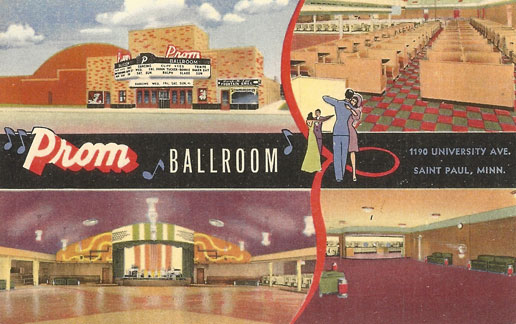
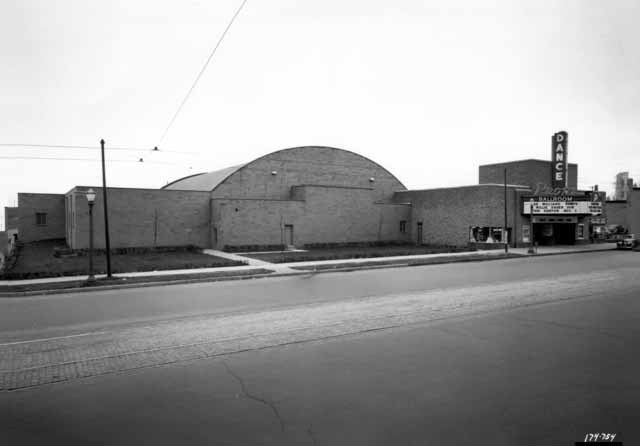
October 29, 1947 Photo courtesy Minnesota Historical Society
THE LOBBY
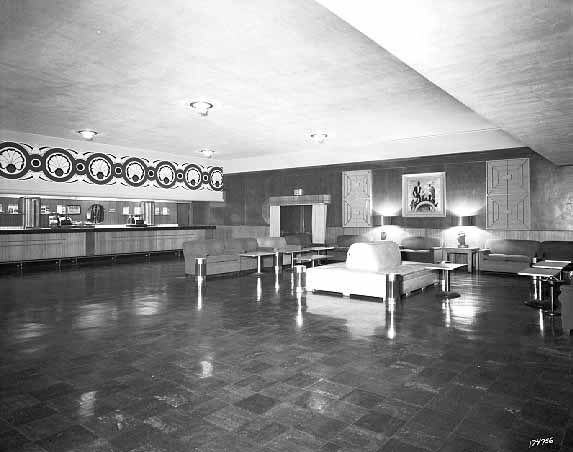
October 29, 1947 photo courtesy Minnesota Historical Society
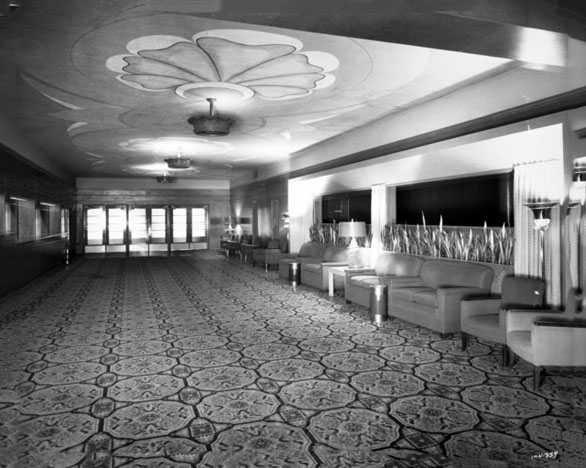
1955 Photo Courtesy Minnesota Historical Society
THE LOUNGE
In April 1956 the Prom advertised that it had been fully redecorated throughout, with glamorous new lighting, smart new murals and appointments.
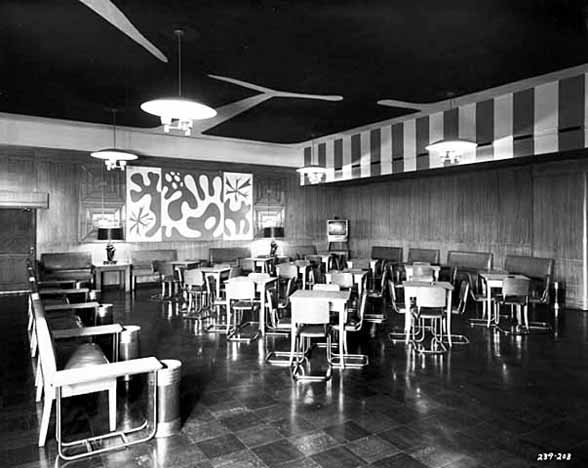
August 1, 1956 Photo Courtesy Minnesota Historical Society
Ad from 1966: “Those who have not attended the Prom since college days, we now have complete cocktail lounges and comfortable seating!”
THE BAR
Only soft drinks were served at the Prom – ads specifically read “No Hard Liquor Allowed!” Cedric Adams tells us that the bar was 72 feet long and was made out of one solid piece of redwood.
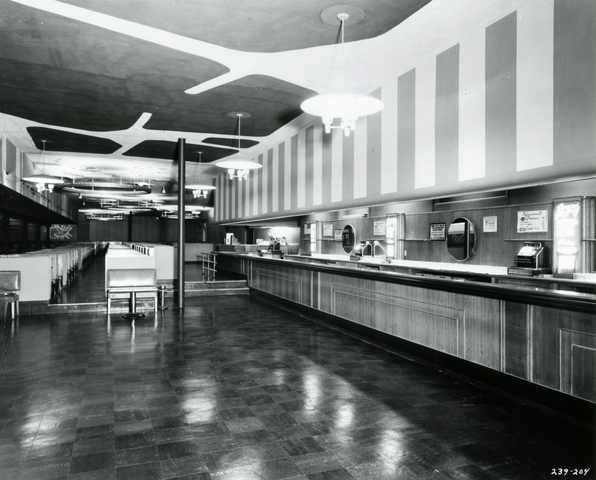
1950 Photo courtesy Minnesota Historical Society
SEATING
There were seven rows of booths.
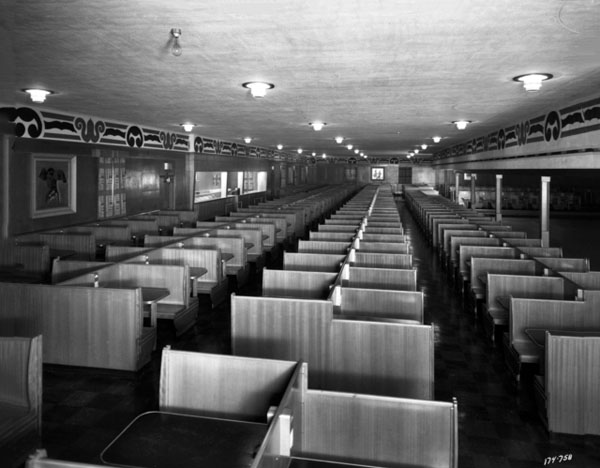
Booth area, 10-29-1947. Photo courtesy Minnesota Historical Society
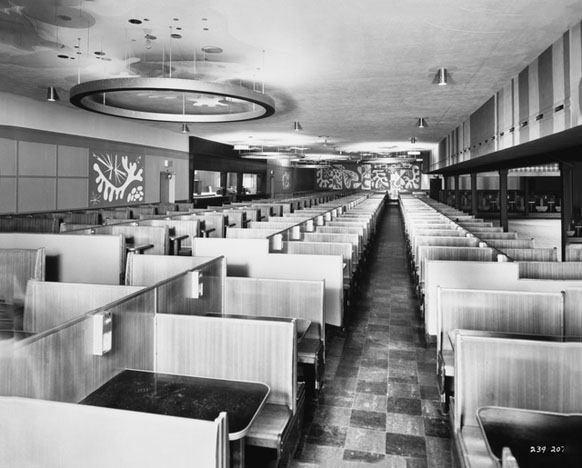
1950 Photo courtesy Minnesota Historical Society
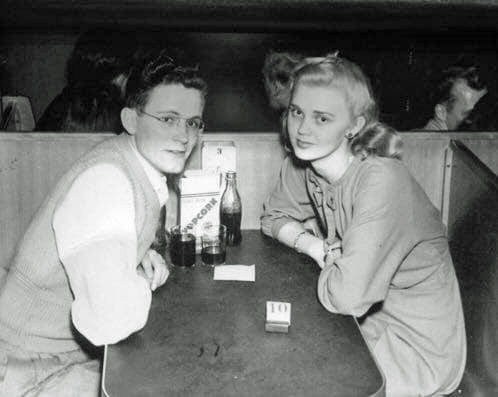
Bill Skon and Helen Wingblade on a date at the Prom. Photo courtesy Ronald Skon, their son!
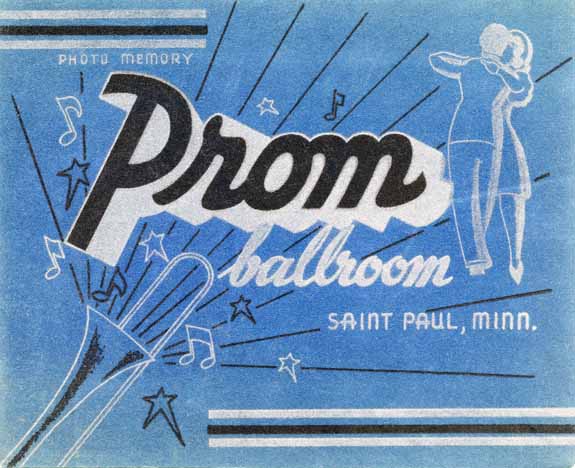
Image courtesy Randy Kirihara
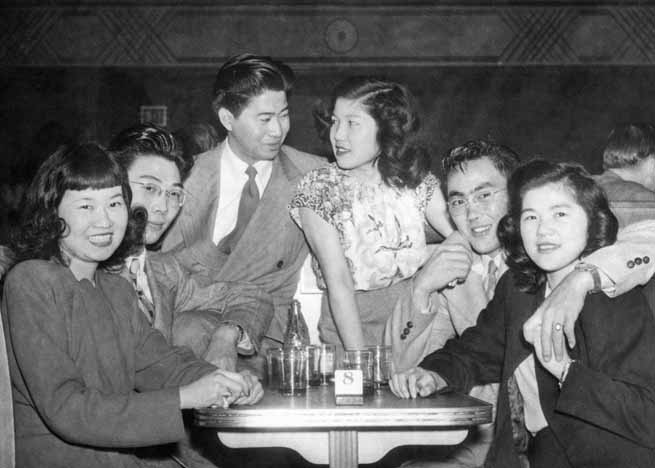
Another date photo from Randy Kirihara, January 26, 1947. The back of the folder says Warren Photo Shop.
THE DANCE FLOOR AND BANDSTAND
Cedric Adams wrote that the dance floor had 12,000 square feet, and next to the Trianon in Chicago, it was the largest ballroom between Chicago and the West Coast. Up to 2,000 people could dance at one time. The dance floor was made of maple and laid “log cabin” style, which allowed dancers to always dance with the grain of the wood.
The bandstand could seat two bands at one time.
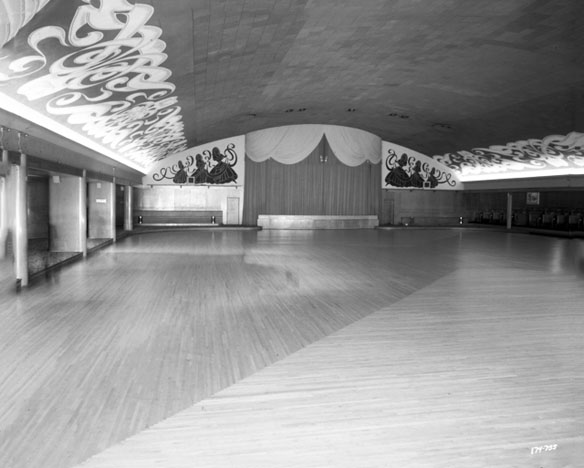
October 29, 1947. Photo courtesy Minnesota Historical Society
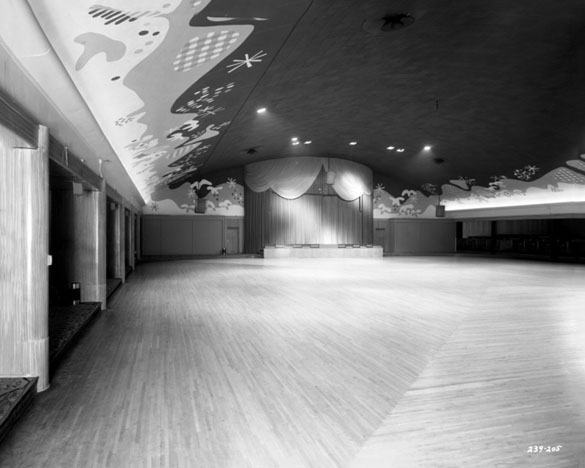
Photo courtesy Minnesota Historical Society
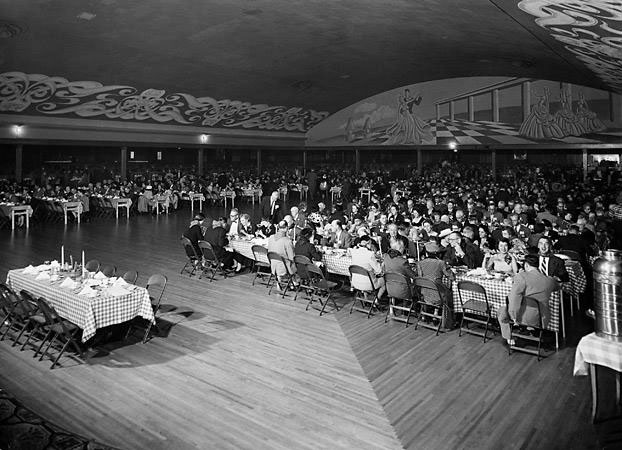
Photo Courtesy Minnesota Historical Society
ACTS AT THE PROM
The grand opening of the Prom was on March 26, 1941. Contrary to Urban Legend, the Prom was not opened by the Glenn Miller Orchestra, but by the Paul Moorhead band from Omaha, and the Royce Stoenner band from Kansas City (who?).
This also calls into question the claim that 9,000 people showed up and 3,000 of them had to be turned away. Cedric Adams wrote that the building held 3,500.
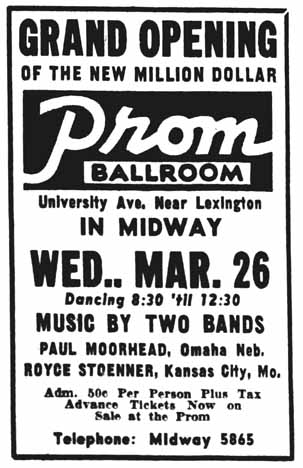
Minneapolis Star Journal, March 21, 1941
March 27, 1941: Whoopie John hosted the Prom’s “First Old Time Dance.”
March 28, 1941: Ralph Slade and His Orchestra
March 29, 1941: Nat Towles, “Southland’s Greatest Colored Band”
March 30, 1941: Paul Moorhead
The Blue Barron Orchestra appeared on April 2, 1941, advertised as the Prom’s “First Name Band.”
April 11, 1941: Henry Busse the Trumpet King, composer of “Hot Lips”
April 15, 1941: Count Basie, “The Sepia Sensation of the Nation,” with vocalists Helen Humes and James Rushing
April 23, 1941: Cab Calloway and his Cotton Club Orchestra, featuring the Four Cab Jivers.
June 1, 1941: Tiny Little
Ted Fio Rito came to the Prom on June 4, 1941. His entourage included Candy Candido, “The Many-Voiced Man;” song stylist Alan Cole; Frank Flynn on drums and vocals; Bert Traxler on sax; and the Three Chicks. Fio Rito was a pianist and a songwriter.
The Prom promised audiences would “Swing and Sway with Sammy Kaye” on August 13, 1941. Kaye had the “So You Want to Lead a Band” schtick, recruiting members of the audience to try their hands at the baton. His singers were Tommy Ryan, Charlie Ryan, and the Three Kadets.
A “Boogie for Britain” jam session and dance originally scheduled for the Lyceum Theater was transferred to the Prom on September 14, 1941, to hold more people. Proceeds of the event went to Bundles for Britain.
Johnny “Scat” Davis appeared at the Prom on October 1, 1941. Davis was a comedian, trumpeter, and scat singer. He had appeared in the films “Brother Rat,” “Hollywood Hotel,” and “Cowboy From Brooklyn.”
October 27, 1941: Artie Shaw and His Orchestra made a one-night stand, bringing “$1,000,000 in Talent.” His girl singer was Paula Kelly.
Henry Busse, orchestra leader and trumpet player of “Hot Lips” fame, entertained at the Prom on November 6, 1941.
Did you know the Prom had a bowling alley? Neither did I! A Duck Pin bowling alley to be exact, with 22 regulation duck pin lanes. G.D. Myers was the Manager of this endeavor. It may not have lasted long.
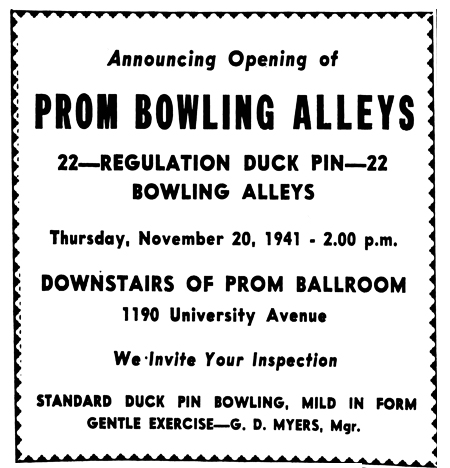
Minneapolis Star
December 31, 1941: Jay McShann was the entertainer – he was more of a rhythm & blues musician.
1942
Frank Sinatra appeared at the Prom Ballroom on March 25, 1942.
Richard Himber, whose orchestra was apparently famous enough to merit notice in the paper, appeared at the Prom on May 13, 1942.
Glenn Miller did make it to the Prom on June 1, 1942. Featured vocalists were Ray Eberle, Tex Beneke, and Marion Hutton. Cedric Adams’ column of May 16, 1942, in the Minneapolis Star Journal suggested that Miller had last been to Minneapolis four years before “as a sort of professorial gent” at the Nicollet [Hotel’s] Minnesota Terrace.” Where the myth that he opened the Prom came from is unknown but will probably never go away!
June 7, 1942: Will Bradley’s OrchestraJune 12, 1942: Don Strickland Orchestra
June 13, 1942: Bennett-Greten Orchestra
June 14, 1942: Tiny Little and his band
June 16, 1942: Louis Armstrong, “Sepia Hot Trumpet Player” and his Orchestra
June 18, 1942: Bennett-Greten Orchestra
June 28, 1942: Bobby Griggs Band
July 1, 1942: Doc Lawson
July 2, 1942: Ted Johnson
On July 3, 1942, Don Graetell led Cliff Keye’s band while Keyes served in the Navy.
July 4, 1942: Glad Olinger
July 5, 1942: Court Hussey’s debut at the Prom
July 8, 1942 appears to be the first of hundreds of appearances by Woody Herman and his orchestra.
July 9 – 12, 1942: Lee Williams’ debut
July 12, 1942: Ted Johnson mixed old-time and modern for the 28 and over crowd.
July 15, 1942: Don Strickland
July 16, 1942: Ted Johnson
July 17, 1942: Blue Barron Orchestra
July 18, 1942: Bobby Griggs
July 19, 1942: Court Hussey
August 2, 1942: Guy De Leo
August 5, 1942: Jimmy Dorsey
August 7 and 8, 1942: Tony Pastor
On September 11, 1942, the Prom staged a “blackout stomp,” whereby the lights were turned off on the jitterbuggers every 20 minutes. “There should be some pretty wild collisions from that,” reported Cedric Adams.
Cliff Kyes’ Orchestra entertained on October 3, 1942.
The music on October 4, 1942, was provided by the Lynn Kerns Rhythm Club.
November 13 to 15, 1942: Boyd Raeburn
November 18, 1942: Jimmy Lunceford
November 20, 1942: Al Menke
November 21, 1942: Lynn Kerns
November 22, 1942: Cliff Kyes
November 27, 1942: Larry Villendrer
November 28 and 29, 1942: Tiny Little
December 2, 1942: Stan Kenton
December 4 to 6, 1942: Al Jarrett “Your Singing Movie Star” and his Orchestra.
Charles Fox was identified as the owner of the Prom in December 1942.
1943
This appears to be a pretty fallow year in terms of big name entertainment because of the War.
April 2 and 3, 1943: Hometown girl Patty Ross returned to Minneapolis while singing with the Clyde Lucas Orchestra. Lucas was from Minneapolis, Kansas.
On October 24, 1943, it was announced that Guy De Leo, who had been leading the orchestra at the Prom for several months, had joined the Marine Corps.
1944
In June 1944, mean old manager Earl Harding banned jitterbugging at the Prom, claiming that only 8 Percent of his patrons indulged in the fancy dancing, and it interfered with or injured the other dancers. The aggravated hoppers took their case to the Mayor of St. Paul and demonstrated their moves, with the hopes of enlisting his help in lifting the ban. The Mayor appointed Milton Rosen, the commissioner of public works, to look into the mater. Well that makes perfect sense. Rosen’s verdict: “I saw some jitter-bugging last night, and frankly, I don’t think it is conducive to good health.” (Minneapolis Star Journal, June 27 and 29, 1944)
Tommy Dorsey, His Trombone, and His Orchestra (49 people) were busy in December 1944. On Saturday the 16th they played a dance at the Prom, and on Sunday the 17th they were at the Minneapolis Auditorium for a modern concert at 3pm and a dance at 8 pm. Apparently the “Sentimental Gentleman of Swing” was on trial for hitting a guy but evaded jail to make the $4,500 gigs. (Minneapolis Star Journal, December 8, 1944)
1945
Frankie Carle came to town in late July 1945, introducing a new girl singer who turned out to be his daughter. She was married to his piano player. It was her first performance with the band.
September 5, 1945: Sonny Dunham and All His Stars
September 1945: Ted Weems
1946
Harry Cool, a graduate of Minneapolis’ West High, brought his new band to the Prom on May 8, 1946. He had been a singer with many different bands before starting his own unit less than a year before this appearance.
May 17, 1946: Stan Kenton and his orchestra, Look magazine’s nomination for Dance Band of 1946. Kenton’s singers were June Christy and Gene Howard. He was heading west for movie work.
May 27, 1946: Spike Jones and His City Slickers made their first dance date in the ‘Cities. They had been here before as part of movie packages only.
On July 24, 1946, comedian Jerry Colonna headed a “Hollywood Jamboree” stage show. Performers included:
- Tony Romano, singing guitarist
- Fay McKenzie, stage and screen singer
- Bonnie Lou Williams, former singer for Tommy Dorsey
- Billy Butterfield’s Band
Oh oh. Guess the jitterbug ban was lifted, but someone always wrecks it for everyone and now Eleanor claimed she was permanently damaged by some hep cat and sued the Prom for $20,000. Damn.
On December 16, 1946, it was announced that Carl and Emma Fox and Maxine Warren sold the Prom, Terp, and Surf Ballrooms to the Chicago company that owned the Aragon and Trianon Ballrooms in that city. William Karzas was the managing director of Aragon and Trianon. (Minneapolis Star and Journal)
1947
On January 30 and 31, 1947, the Prom presented Cecil Golly’s Orchestra, featuring Mildred Stanley and Jimmy Shepard.
March 5, 1947: Raymond Scott and Lee Williams alternated.
Duke Ellington played for 1,000 students and their dates at the U of M’s Senior Prom – at the Prom. April 10, 1947. 18 piece orchestra – a true Big Band!
Here’s an ad from June 14, 1947, featuring Harry Given, who appears to have been a local orchestra leader.
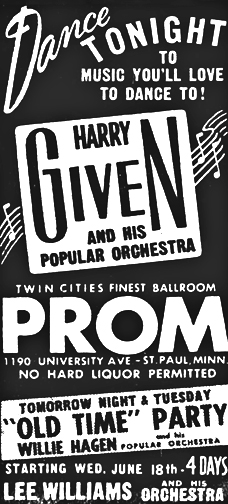
Minneapolis Tribune
June 15 and 16, 1947, featured Prom regular Willie Hagen.
On June 18 to 21, 1947, the Prom presented Lee Williams and His Orchestra.
July 16, 1947: Charlie Spivak, trumpet player and bandleader
Tony Pastor was in town on July 30, 1947 – buy his records at the Gates Music Shop, 817 Hennepin.

Minneapolis Star
October 18, 1947, brought Lee Williams and His Stepping-Tone Music. Sounds intriguing!
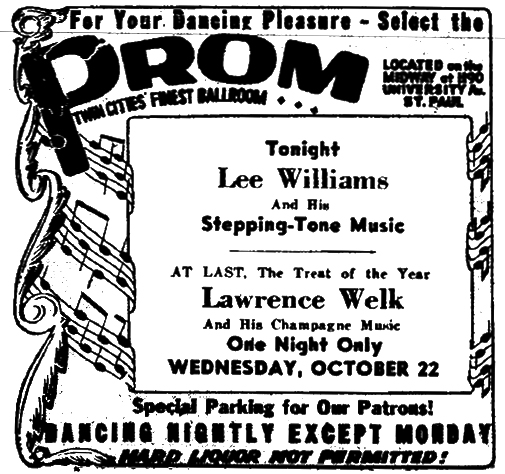
Ad courtesy Robb Henry
Lawrence Welk, a big favorite, appeared at the Prom on October 22, 1947.
The first annual Page One Ball, also known as the Newspaperman’s Ball, was held on November 17, 1947. Ted Weems was scheduled to appear, but later reports said that music was provided by Claude Thornhill’s band. Also performing was Dorothy Shay, the “Park Avenue Hillbilly,” famous for that classic ditty “Feudin’ and Fightin.'”
Claude Thornhill made a repeat appearance on November 19, 1947.
1948
Harry Cool returned to the Prom for the week of January 9, 1948, and made a stop at an open house at Don Leary’s Record Store on January 10.
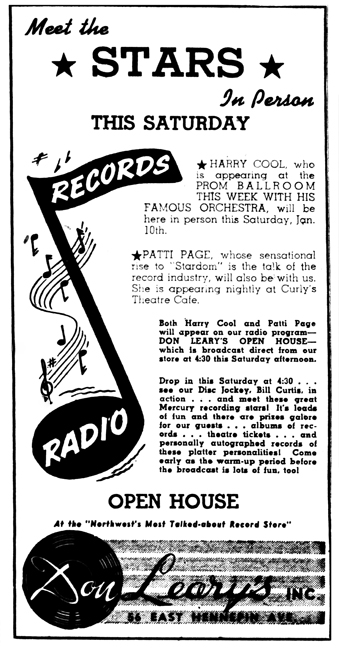
Minneapolis Tribune
KSTP-TV was the first television station in Minnesota, and its first broadcast was of a dinner on April 26, 1948, from the Prom, with speakers from 7:30 to 8:00 pm, and a stage show from 8 to 9 pm. This program was telecast on KSTP, and TV dealers had sets in their showrooms for people to watch. Speakers included representatives of Northern States Power, the National Broadcasting Company, RCA, and Stanley E. Hubbard, president of KSTP-TV. Dr. J.O. Christianson of the University of Minnesota presided. (Minneapolis Star, April 23, 1948)
Some local musicians that took part in the first telecast were Johnny Bravus (sic), tenor; Jack Donovan, trombone; Dougie Peterson, bass; Sid Osterlund, drums; and Wally Morgan, piano. The effort was masterminded by John (?) Wolf, a local radio DJ. Kenneth Stuart says he wasn’t there but roomed with Jack Donovan who said it was a “trip.”
On June 8, 1948, the Prom hosted Alvino Rey, “America’s Number 1 Guitarist,” and his Orchestra.

Minneapolis Tribune
June 22, 1948, brought Ray McKinley, a triple threat on drums, vocals, and bandleader. The girl singer was Marcy Lutes.
July 14, 1948: Woody Herman played the clarinet and saxophone. His band featured the Four Chips, and vocalist Jeri Ney.
September 1, 1948: Banjo player Art Mooney, famous for his rendition of “I’m Looking Over a Four-Leaf Clover.”
On December 18, 1948, the St. Paul Musicians Association and the Prom offered a free “Twin City Teenage Hi-Hop,” featuring the orchestras of:
- Red Knapton
- Ray Winkler
- Harry Given
The Prom was advertised as “Minnesota’s Wonder Ballroom” and promised “Dance & Romance.”
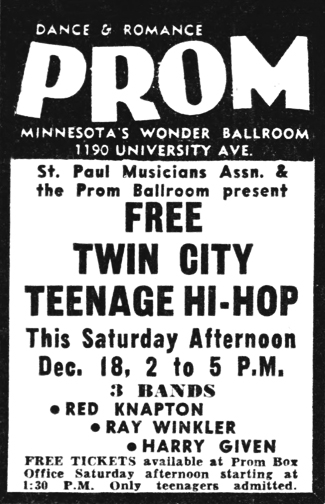
Minneapolis Tribune
1949
February 25, 1949: Ted Weems and His Orchestra
March 1, 1949: Vaughn Monroe
On April 28, 1949, the Prom hosted an unusual Western Night, featuring Country stars from KSTP radio:
- Billy Folger
- Fiddlin’ Russ
- Cactus Slim
- Andy Walsh
- Chuck Mulkern
- Kim Weston
- Kathy Kohles
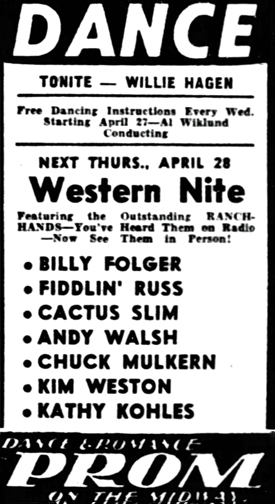
Minneapolis Tribune
On May 17, 1949, the Prom hosted Radio Fun Night, a benefit for B’nai B’rith. It featured the following local DJs:
- John Ford
- Jim Boyson
- Jack Thayer
- Dick Enroth
- Clellan Card
- Bill Wigginton
- Cal Karnstedt
- Don Hawkins
- Sev Widman
- Sherm Booen
- Marty O’Neill
- Norm Paige
- Slim Jim
- Bill Daley
Dick Jurgen’s band appeared at the Prom on August 10, 1949. The unit was named “Treasury Band of 1948” by the U.S. Treasury Department. What could that have been about?
On August 17, 1949, WTCN broadcast a 30 minute show from the Prom featuring Lawrence Welk’s Champagne music, coast to coast. The ad is unclear but seems to indicate that it was broadcast on both radio and TV. The show was sponsored by Miller High Life beer.
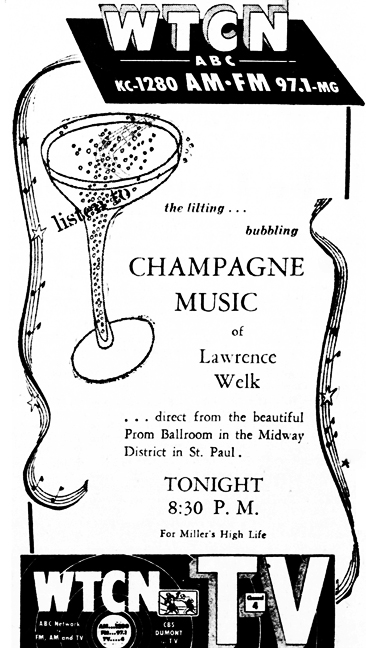
Minneapolis Star
September 21, 1949: Woody Herman arrived with drummer Shelly Manne, “trombone notable” Bill Harris, and singer Mary Ann McCall. The Minneapolis Tribune reported that “Herman, it may be remembered, has espoused bop, at least in spirit, in his recent feud with Tommy Dorsey.” (September 18, 1949)
October 26, 1949: Elliot Lawrence and his Famous Band, featuring Rosalind Patton and Jack Hunter
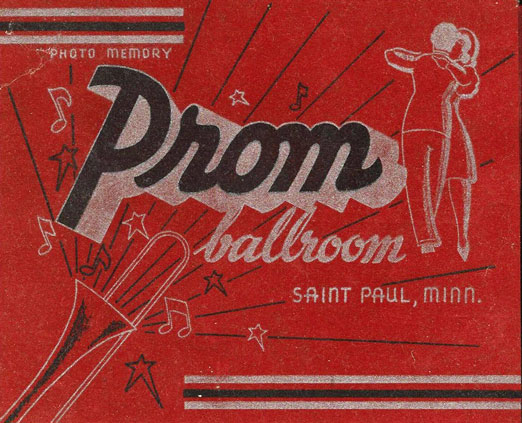
This is the cover of a folder that kept the photo the roving photographer took of you having fun at the Prom. Image courtesy Josh McKeown.
Date unknown: Artie Shaw was in town in 1949, with vocalist Pat Lockwood.
1950
The Blue Barron Orchestra performed on January 20, 1950. They had just had a hit record, “Cruisin’ Down the River.” They came back many times but that was their only/biggest record. Vocalists with the band were Bobby Beers and Betty Clark.
RACIAL DISCRIMINATION AT THE PROM
On February 4, 1950, two foreign students from the U of M were not allowed to enter the Prom when they went there with an American couple. One was from Surinam, formerly Dutch Guinea, and one from China. The University was up in arms about the incident, and Don Simon, president of the All-University Congress wrote a letter to James C. Alexander, general manager of the Prom, telling him that many students believed that the incident was a “discriminatory practice.”
Alexander apologized to the students and allowed them into the ballroom for free. Simon followed up with a letter telling Alexander that the students have come “to accept as equals people of all nations and races,” and asked for the Prom’s admission police toward university students. Alexander responded that any member of the University was “presumed to be of good moral character” and could enter the ballroom.
But when asked about groups outside of the University, Alexander said, “We have a definite standard. And we don’t want that standard compromised by prostitutes, alcoholics, or people who would be held in disrepute by the community.”
The St. Paul Council on Human Relations tried to arrange a meeting with Alexander over the incident with the foreign students. Executive Secretary Ruth Abernathy said, “We feel that now is the time to bet a statement of their complete policy,” but Alexander said that a meeting was not necessary because he had apologized to the students and he considered the incident closed. (Minneapolis Tribune, February 25, 1950)
March 3, 1950: Clyde McCoy and his Orchestra played their only Upper Midwest date in their move from the West Coast to the East. McCoy was known for the song “Sugar Blues.”
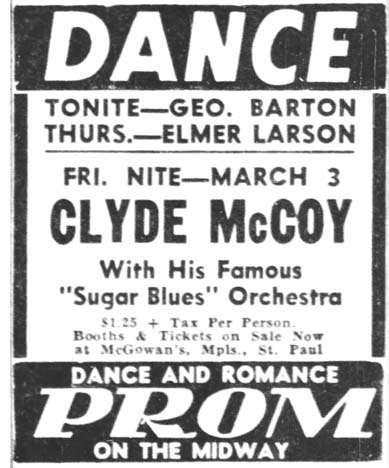
Minneapolis Tribune, Sunday, February 26, 1950
March 8, 1950: Ray Anthony and his Orchestra. Anthony had played trumpet in Glenn Miller’s band from 1940–1941, and appeared in the Glenn Miller movie Sun Valley Serenade before joining the U.S. Navy during World War II. After the war he formed his own group. The Ray Anthony Orchestra, which became popular in the early 1950s with its recordings of “The Bunny Hop,” ” The Hokey Pokey,” and the theme from Dragnet. Later on. Anthony was also famous for his 1955-1959 marriage to Mamie Van Doren. The Tribune said he could double as Cary Grant…
March 17, 1950: Henry Busse and his Orchestra. Henry Busse, Jr. and his mother had settled in Anoka after the parents’ divorce. Junior was not up to snuff playing the trumpet, but was attending the Beck School for Radio in Minneapolis, studying to be a disc jockey.
April 12, 1950: Russ Morgan and His Orchestra. The band had a big hit with “So Tired,” and didn’t often make one-night stands.
May 12, 1950: Guy Lombardo made his first Upper Midwest appearance in more than ten years. His vocalists included Carmen, Liebert, and the Lombardo Trio.
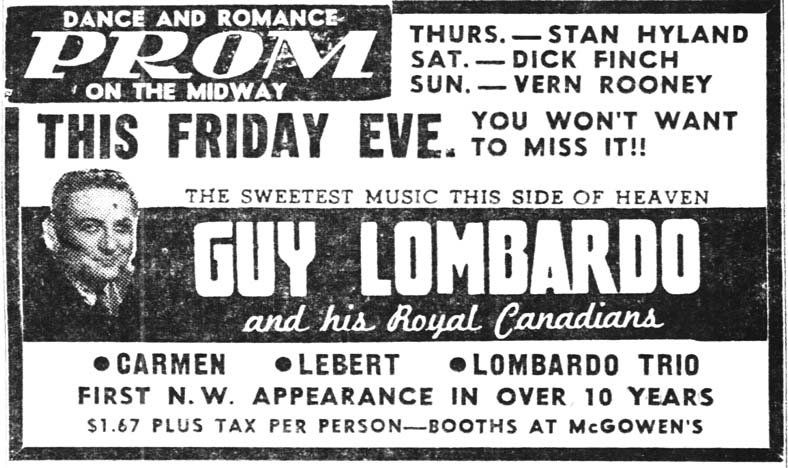
Minneapolis Star, Tuesday, May 9, 1950
May 17, 1950: Jimmy Dorsey and his orchestra of 18. He extolled the Dixieland revival and had a band-within-a-band featuring Charlie Teagarden. Also featured were Ray Bauduc and Shorty Sherock.
May 21, 1950: Ferde Oldre was a veteran Minneapolis bandleader. He was booked for every other Sunday night. He played piano, violin, and banjo, and during intermission he lead community singing.
June 3, 1950: Bandleader Jan Garber made his first appearance in the area in more than a decade. He came with three vocalists.
July 14, 1950: Art Mooney made his second appearance in two years.
July 19, 1950: Charlie Spivak arrived with his 18-piece band. Spivak played the trumpet. Vocalists were Pat Collins and Tommy Lynn.
August 11, 1950: Tony Pastor and his 18-piece band had a “novelty style.”
August 18, 1950: Blue Barron’s Orchestra
The annual Musicians’ Ball was held at the Prom on September 27, 1950. The show featured 12 bands.
September 29, 1950: Tiny Hill and his “shuffle boat” Orchestra. Tiny weighed in at 386 pounds, and his theme song was “Angry.”
October 4, 1950: Harry James and his 20-piece Orchestra. Can you imagine seeing Harry James for a buck and a quarter?
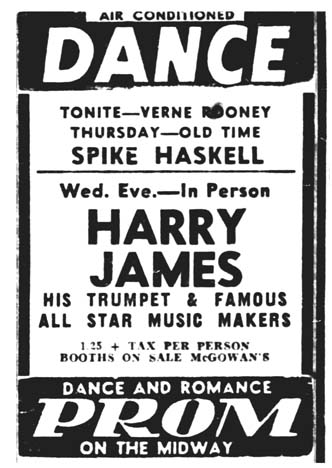
Minneapolis Tribune, Sunday, October 1, 1950
October 11, 1950: Sammy Kaye and his 18-piece Orchestra featured six vocalists. Kaye had a “So You Want to Lead a Band” feature.
November 1, 1950: Hal McIntyre and His Orchestra played the Prom; his first date in the area in three years.
November 17, 1950: Ralph Flanagan and His Orchestra was number one on college campuses. His style was compared to that of Glenn Miller.
1951
The Arizona Room in the basement of the Prom opened around this time. It was a smaller room, available for private parties.
January 12-14, 1951: Clyde Mc Coy.
Yogi Yorgesson came to the Prom on January 31, 1951. Yogi was of Norwegian descent, but played a Swede on his 40-some records, thick with dialect. Although he was from Tacoma, Washington, he was very popular here in Minnesota, ya know.
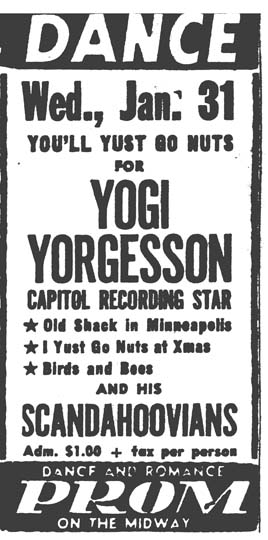
Minneapolis Tribune, Friday, January 26, 1951
February 2, 1951: Stan Kenton
March 16 – 18, 1951: Tommy Dorsey and his 18-piece orchestra
April 13, 1951: Pianist Frankie Carle
April 18, 1951: The Sammy Kaye Orchestra featured five male and three female vocalists
April 24, 1951: Yogi Yorgesson made a repeat appearance. He’s funny but how can you dance to “I Yust Go Nuts at Christmas?”
Cedric Adams reported that Prom management instituted Thursday night “Mixer Dances” designed for singles to get acquainted. Sounds like the Friendship Club in Minneapolis. (Minneapolis Star, April 26, 1951) There was also something called “scampers” mentioned in an ad on June 7, 1951.
Gene Krupa and his 20 piece orchestra came for a four night stand, May 10 – 13, 1951. Also featured were three vocalists.
JULES HERMAN
What’s this? I may have found the first time Jules Herman graced the bandstand at the Prom. Try June 7, 1951.
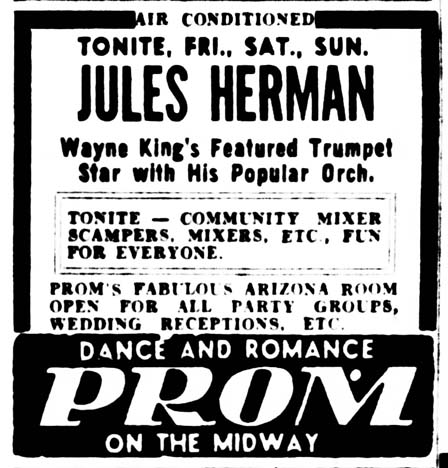
Minneapolis Tribune, Thursday, June 7, 1951
Held over, and then held over again, and so on, and so on. His became the house band at the Prom for decades. Herman was inducted into the Minnesota Music Hall of Fame in 2002. His entry reads:
Trumpeter and bandleader, Jules Herman, was born to musical parents. He earned college degrees in music and history at Moorhead State playing his horn. After teaching for a short time, Lawrence Welk hired Herman as first trumpet, which began his musical career, playing hotels and clubs nationally with Welk and various bands including Wayne King. In 1950 he organized his own band and after a year of club dates became the “house band” at the famous Prom Ballroom until it was sold and razed in 1986.
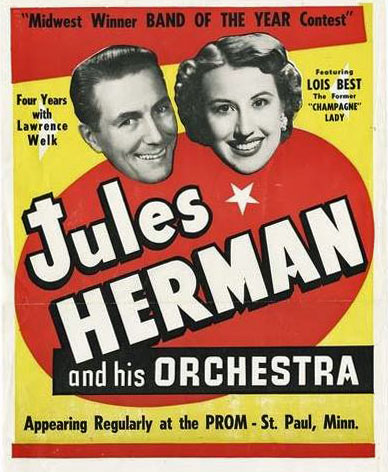
Image courtesy Minnesota Historical Society
July 20, 1951: Les Brown
July 27 -29, 1951: Charlie Spivak, “the man who plays the sweetest trumpet in the world.
August 10, 1951: Ray Anthony
Will Jones reported that Les Paul and Mary Ford would be coming to the Prom, but they were red hot and working in New York for megabucks.
September 28 and 29, 1951: Harry James
October 5, 1951: Woody Herman. His smaller, recording unit was called “The Herd.”
November 9, 1951: Tony Pastor Orchestra, with vocalist Rosemary Clooney, his new discovery.
1952
Jimmy Dorsey appeared at the Prom Ballroom, February 16, 1952
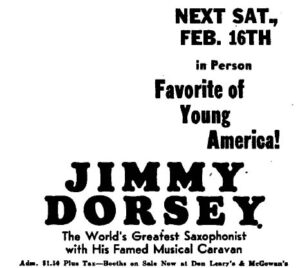
Minnesota Daily, February 7, 1952. Ad courtesy Robb Henry
Frankie Carle appeared at the Prom Ballroom, March 21, 1952.
Spike Jones and His City Slickers – New Musical Depreciation Revue of 1952 appeared at the Prom Ballroom – April 5, 1952. The ad promised 44 performers!
Stan Kenton appeared at the Prom Ballroom, April 25, 1952
Vaughan Monroe, star of the Camel Caravan, with Orchestra, Vocalists, Entertainers – The Most Talked About Band in America – appeared at the Prom Ballroom, May 9, 1952
Blue Barron Orchestra appeared at the Prom Ballroom, May 16, 1952
Ray Anthony, the Young Man with the Horn appeared at the Prom Ballroom, May 23, 1952
Ralph Flanagan Orchestra appeared at the Prom Ballroom, June 6, 1952
Les Brown appeared at the Prom Ballroom, June 27, 1952
Don Cornell appeared at the Prom Ballroom, July 19, 1952
Woody Herman appeared at the Prom Ballroom, July 25, 1952
Ralph Marterie appeared at the Prom Ballroom, August 2, 1952
Clyde McCoy and his Sugar Blues Orchestra appeared at the Prom Ballroom, August 8 and 9, 1952
Fresh Approach of Billy May appeared at the Prom Ballroom, August 15, 1952
Neal Hefti, Frances Wayne, and the Cavaliers appeared at the Prom Ballroom, August 29-30, 1952
The very cool Ella Mae Morse appeared at the Prom Ballroom on October 4, 1952.
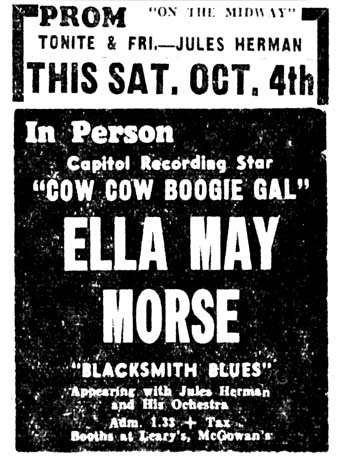
Minneapolis Tribune, Sunday, September 28, 1952
Tony Pastor, King of the Saxophone appeared at the Prom Ballroom, October 10, 1952
Pee Wee King, America’s Number 1 Western Dance Band, appeared at the Prom Ballroom on October 25, 1952.
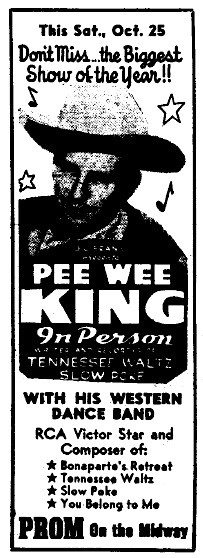
Minnesota Daily, October 1952. Ad courtesy Robb Henry
Harry James appeared at the Prom Ballroom, October 31 and November 1, 1952
Clyde McCoy and his Sugar Blues Orchestra appeared at the Prom Ballroom, November 14, 1952
Billy May’s Orchestra appeared at the Prom Ballroom, November 28 and 29, 1952
Clyde McCoy and his Sugar Blues Orchestra appeared at the Prom Ballroom, December 27, 1952
1953
Blue Barron, Music of Yesterday and Today appeared at the Prom Ballroom, appeared at the Prom Ballroom on January 16, 1953
Les Brown appeared at the Prom Ballroom on February 21, 1953.
Jan Garber appeared at the Prom Ballroom on April 10, 1953
Eileen Barton appeared at the Prom Ballroom on April 17, 1953. She was best known for the song “If I Knew You Were Comin’ I’d a Baked a Cake.”
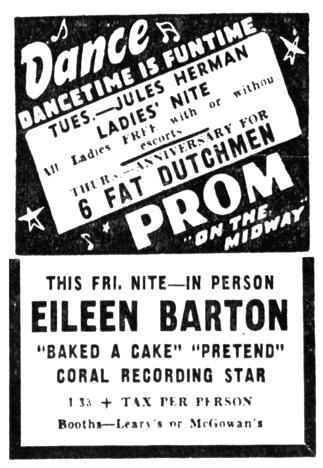
Minneapolis Tribune, Monday, April 13, 1953
Ray Anthony appeared at the Prom Ballroom on April 20, 1953
Henry Busse and His Famous “Hot Lips” Orchestra appeared at the Prom Ballroom on May 18, 1953
Dick Jurgens appeared at the Prom Ballroom on June 5, 1953
Bobby Wayne with Tommy Reed and Orchestra appeared at the Prom Ballroom on June 12, 1953
Ralph Marterie and His Down Beat Orchestra – “The Man Born for the Horn” – appeared at the Prom Ballroom on June 26 and 27, 1953
Ralph Flanagan appeared at the Prom Ballroom on July 10 and 11, 1953.
Sauter-Finegan Orchestra – 25 musicians and singers – appeared at the Prom Ballroom on July 21, 1953
Frankie Carle – piano and orchestra – appeared at the Prom Ballroom on July 24, 1953 – piano and orchestra
Les Brown appeared at the Prom Ballroom on August 21 and 22, 1953
Tommy and Jimmy Dorsey appeared at the Prom Ballroom on October 2 and 3, 1953
Jimmy “Dancing Shoes” Palmer appeared at the Prom Ballroom on October 23, 1953
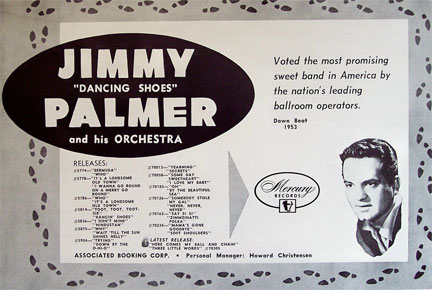
The Prom instituted a new policy on October 17, 1953: **Couples only admitted on Saturdays**
Pee Wee Hunt (Dixieland) appeared at the Prom Ballroom on October 30, 1953
Freddy Martin appeared at the Prom Ballroom on November 6, 1953
Woody Herman and His Third Herd appeared at the Prom Ballroom on November 20-21, 1953
Ray Anthony and His Chesterfield Orchestra appeared at the Prom Ballroom on November 27, 1953.
Country star Hank Thompson entertained at the Prom on December 3, 1953.
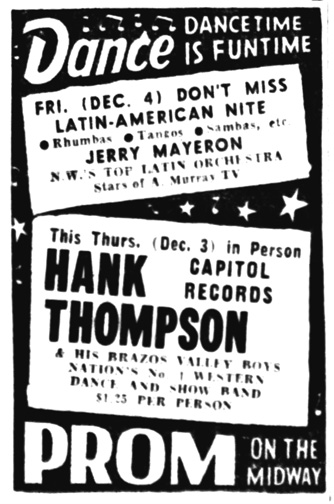
Minneapolis Tribune, Sunday, November 29, 1953
1954
Stan Kenton gave a concert (January 8) and a dance (January 9, 1954) at the Prom Ballroom.
Percy Hughes and Oscar Frazier played at the “Tunic Twirl” for the U of M’s Greek Week. The dance was on February 22, 1954, at the Prom Ballroom, and admission was free if you wore a tunic. Toga!!
Harry James and Buddy Rich came to the Prom Ballroom on June 4, 1954.
Teen-Age dances began on June 23, 1954, and continued every Wednesday, according to an ad of that date.
June 25, 1954: Sam Donohue and the Billy May Orchestra
July 9, 1954: Woody Herman and the Third Herd
August 13: The Big Beat of Buddy Morrow
October 20, 1954, Teen-Age Dance.
On October 22, 1954, the special guest was Ray Anthony, “The Young Man With the Horn, and his Chesterfield Orchestra.
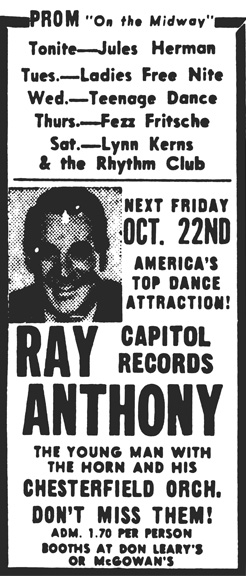
Minneapolis Tribune, Sunday, October 17, 1954
October 23, 1954: Lynn Kerns and the Rhythm Club. Might be kind of modern?
October 27, 1954, was a Teen-Age Dance + The Commanders. Were the Commanders the Smooth band or the Teen-Age Dance band?
October 29, 1954, brought Eddy Howard “and his celebrated orchestra” to the Prom.
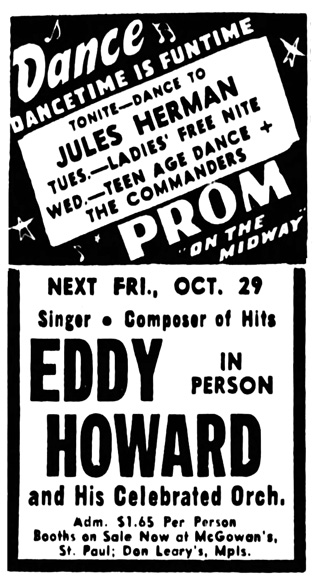
Minneapolis Tribune, Sunday, October 24, 1954
1955
February 2, 1955: Teen-Age Dance
February 3, 1955: Battle of Music: Ray Price vs. Fezz Fritsche
Tex Beneke appeared at the Prom Ballroom on March 23, 1955.
BILL HALEY AND HIS COMETS
Bill Haley and His Comets appeared at the Prom Ballroom on April 6 (teenage only) and April 9 (general public), 1955. This is an extraordinary booking, because it was before “Blackboard Jungle” had hit Minneapolis, and there probably weren’t many who knew who he was. In fact, it was “Shake, Rattle and Roll” that was included in the ad, not “Rock Around the Clock.”
Jules Herman shared the bill on April 6, and Henry Charles on April 9.
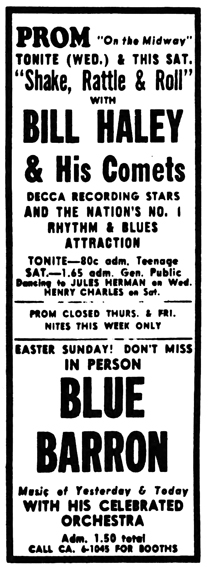
Minneapolis Star, Wednesday, April 6, 1955
The Blue Barron Orchestra appeared on April 10, 1955.
1955 was the beginning of the era of the vocal groups, and just about all of them passed through the Prom at one time or another; many came several times. Included were:
- The Four Lads
- The Four Preps
- The Four Coins
- The Hilltoppers
- Four Freshmen
- Diamonds
- Crew Cuts
The Four Lads appeared at the Prom Ballroom for a Teenage Dance on May 6, 1955.
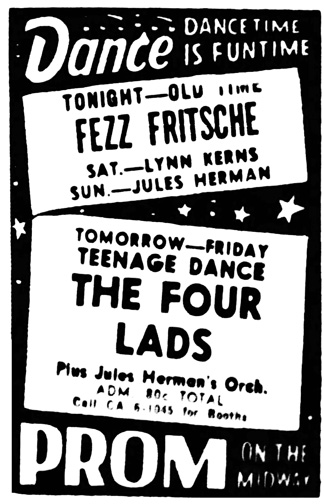
Minneapolis Star, Thursday, May 5, 1955
Webb Pierce with his Wondering Boys and Red Sovine appeared at the Prom Ballroom on June 18, 1955.
Ray Anthony and His Chesterfield Orchestra appeared at the Prom Ballroom on July 29, 1955.
Tex Beneke and his Orchestra appeared on Friday, August 12, 1955.
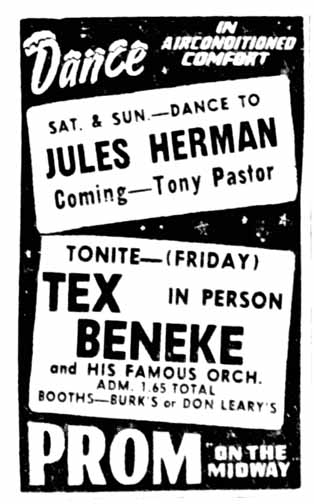
Minneapolis Star, Friday, August 12, 1955
Sunday, September 11, 1955: Lawrence Welk
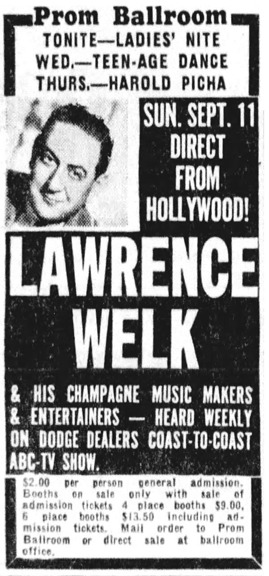
Minneapolis Tribune, September 6, 1955
September 14, 1955: Teen-Age Dance
October 19, 1955: Teen-Age Dance
October 21 and 22, 1955: Ralph Flanagan
October 26, 1955: Teen-Age Dance
October 28, 1955: Johnny Long and His Orchestra.
The Four Lads appeared at the Prom Ballroom on November 5, 1955.
Johnny Desmond appeared at the Prom Ballroom on November 11, 1955.
Pee Wee King appeared at the Prom Ballroom on November 24, 1955.
Eddy Howard appeared at the Prom Ballroom on November 25, 1955.
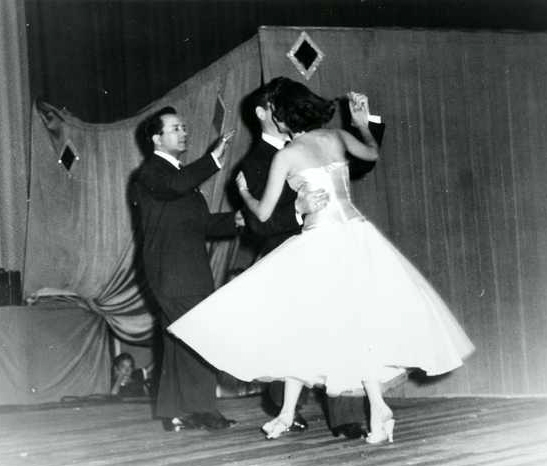
Dancers at the Prom, 1955. Cutting in? Eliminating from a contest? Photo courtesy Minnesota Historical Society
Les Elgart appeared at the Prom Ballroom on December 4, 1955. He also appeared at the Kato Ballroom on December 7.
1956
In 1956 WDGY disk jockeys hosted Saturday dances for adults and teen dances on Fridays (sponsored by Coke).
The Four Freshmen performed on January 7, 1956, at the Prom Ballroom.
The Four Lads performed at the Prom Ballroom on February 11, 1956.
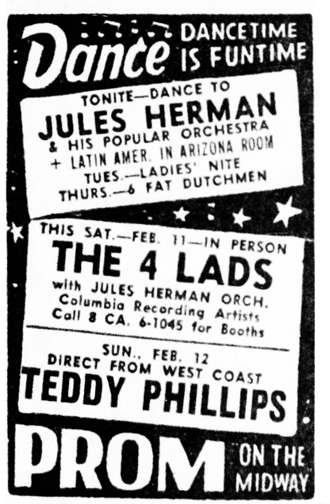
Minneapolis Tribune, Sunday, February 5, 1956
Stan Kenton performed at the Prom Ballroom on February 25, 1956
Buddy Morrow performed at the Prom Ballroom on April 7, 1956. He also performed at the Teen-Age Dance on April 4.
The Amazing Crew Cuts and the famed Music of Blue Barron performed at the Prom Ballroom on April 20, 1956
The Diamonds performed at the Prom Ballroom on May 19, 1956
The ad is confusing, but it looks like the Billy May Band and Sam Donohue were coming for the Teen-Age Dance on May 23, 1956. Yes, there it is. Only teens age 13 to 17 years old were admitted.
Wednesday, May 27, 1956, was a Pepsi Jr. Dance
Thursday, May 28, 1956, featured the Polka Dots. Or people wore polka dots. Or something.
The Billy May Orchestra and Sam Donohue also played for a Gala Memorial Day Eve Dance on May 29, 1956.
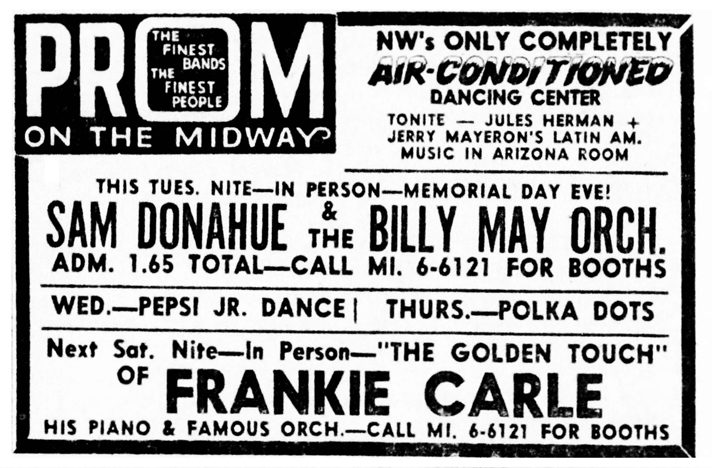
Minneapolis Tribune, Sunday, May 27, 1956
Frankie Carle performed at the Prom Ballroom on June 2, 1956
The Four Coins performed at the Prom Ballroom on June 8, 1956
The Hilltoppers performed at the Prom Ballroom on June 15, 1956. Their biggest hit was “Marianne,” which reached Number 3 on the charts in 1957.
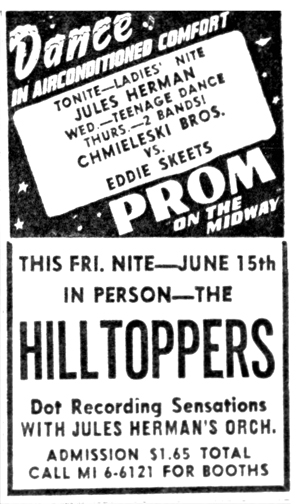
Minneapolis Tribune, Tuesday, June 12, 1956
TEEN-TIME DANCES
Jack Thayer’s Teen-Time Dances started on June 20, 1956, when he was with WDGY. That may have been for the season – he could have been doing them as early as 1952 when he was at WLOL. (When he stopped in 1957, it was noted that he had done them for five years.) The dances were on Wednesday nights. His sponsor was Coca-Cola or Pepsi. When Thayer became General Manager of WDGY in June 1957, Bill Bennett took over the M.C. duties.
Below is the ad for the Jack Thayer Dance for June 27, 1956.
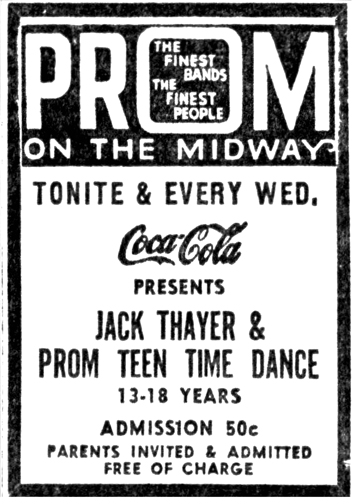
Minneapolis Tribune, Wednesday, June 27, 1956
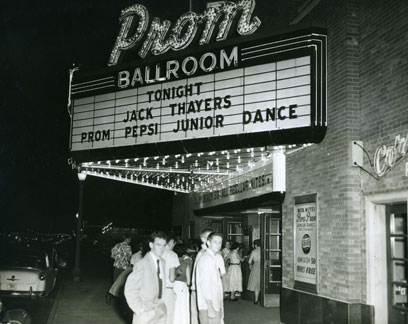
Photo courtesy Pavek Museum of Broadcasting
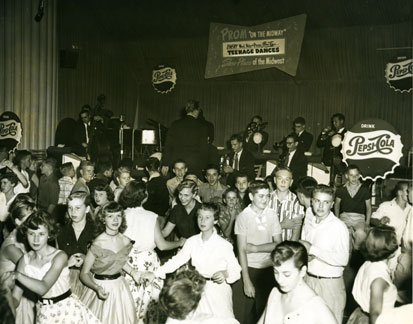
Shot from one of Jack Thayer’s Teen Dances, courtesy Pavek Museum of Broadcasting
Stan Kenton and 22 piece orchestra, July 6 and 7, 1956
Glenn Miller Orchestra under the direction of Ray McKinley, with original arrangements, played the Prom Ballroom on July 28, 1956.
Cathy Carr, August 14 and 19, 1956
Buddy Morrow played the Prom Ballroom on August 24, 1956
So much going on!
On Friday, August 31, 1956, Jack Thayer hosted a Teentime dance, sponsored by Coca-Cola.
On Saturday September 1, 1956, the vocal group the Diamonds, who would go on to record “Little Darlin'” in 1957,” appeared
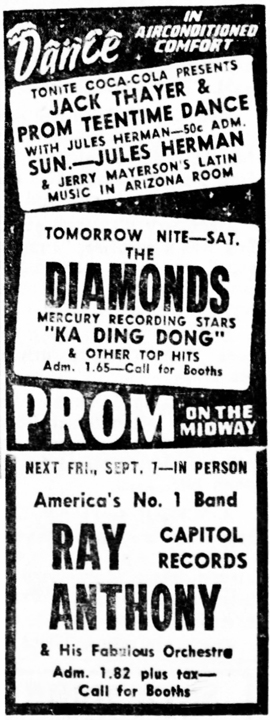
Minneapolis Tribune, Friday, August 31, 1956
Ray Anthony appeared on Friday, September 7, 1956.
On Friday, October 19, 1956, Jack Thayer held his Teentime Dance, sponsored by Coca-Cola.
On October 20, 1956, Bill Bennett, a WDGY DJ, hosted a new “Fun-For-All Gala Saturday night Dance Frolic.
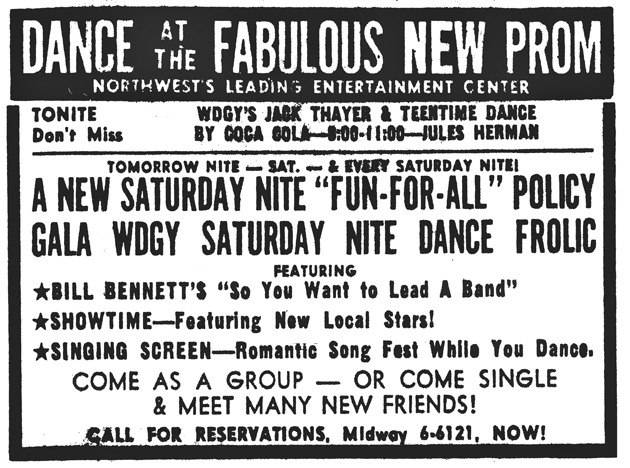
Minneapolis Star, Friday, October 19, 1956
On Saturday, November 3, 1956, Bill Bennett, hosted his “Saturday Night Fun For All WDGY Dance Frolic.”
On Saturday, November 10, 1956, the Gala WDGY “Saturday Nite Dance Frolic” featured:
- Bill Bennett’s “So You Want to Lead a Band”
- Showtime – Featuring New Local Stars!
- Singing Star Sanford Clark
November 21 and 23, 1956, were set aside for “teentime” dances.
On Friday, November 24, 1956, Don Cornell provided the music for a WDGY Dance Frolic Night. DJ Bill Bennett was on hand, as well as Jules Herman.
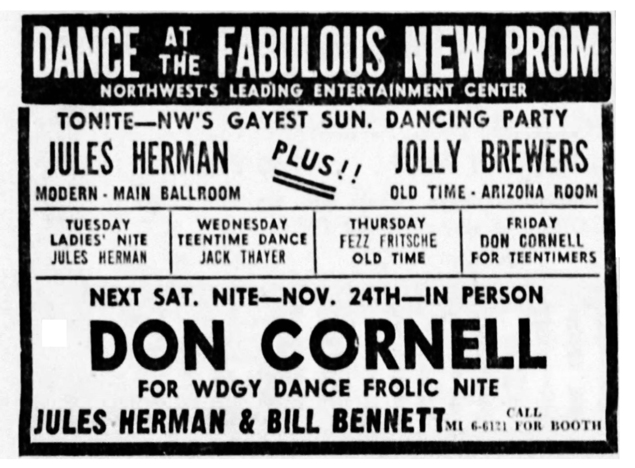
Minneapolis Tribune, Sunday, November 18, 1956
1957
Trumpet player Ralph Marterie performed at the Prom Ballroom on January 5, 1957.
Guy Mitchell appeared at the Prom Ballroom on January 15, 1957.
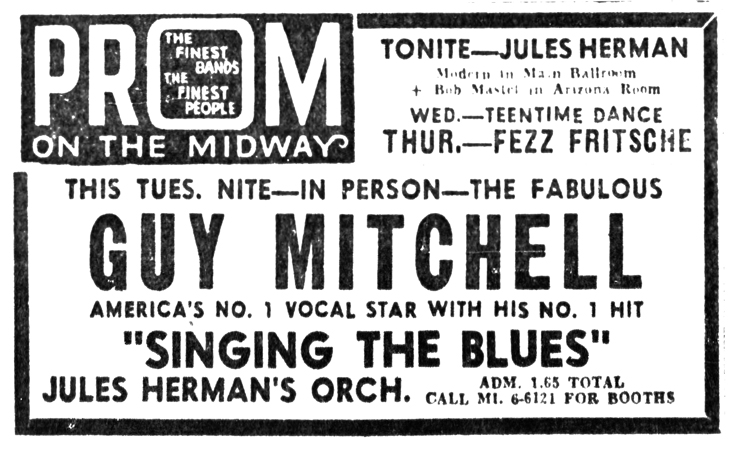
Minneapolis Tribune, Sunday, January 13, 1957
On January 19, 1957, RCA-Victor sent a trainload of its top talent to the Cities as part of its national tour on behalf of the March of Dimes. Once they arrived, they split up to make appearances at many venues around town, including
- All of the TV and radio stations
- A party for record dealers
- The Sister Kenney Institute; the patients were doing so well that only nine were at the hospital that weekend.
- Dayton’s Tea Room; Mary Mc Elmurry remembers, “My mom took me to see Julius La Rosa on the 12th floor. She made me turn my Elvis purse around so no one could see it. Sure wish I still had that purse. It could be worth some bucks!”
- The Prom Ballroom at 9 pm.
Mickey and Sylvia seem to be the only rock ‘n’ roll singers on the list, but there were some some near misses, including Eddie Fisher, Lou Monte, and the Browns.
A rock ‘n’ roll dance party at the Prom in early January 1957 featured Augie Garcia, Bill Samuels, Teddy Guzman, and vocal groups the Septones and the Chickens, reported Will Jones in the Trib. Leigh Kamman was the emcee.
The Diamonds performed at the Prom Ballroom on Friday, January 25, 1957.
Stoop Chamberlain provided the music for the Teen-Time Dance at the Prom Ballroom on Saturday, February 9, 1957. Need to find out more about Stoop!
The Four Freshmen performed at a Teen-Time Dance at the Prom Ballroom on Friday, February 15, 1957.
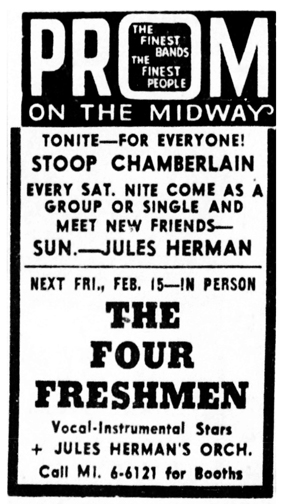
Minneapolis Tribune, Saturday, February 9, 1957
The Statesmen entertained at the Teen-Time Dance at the Prom Ballroom on Sunday, February 10, 1957.
The Crew Cuts came to the Prom Ballroom on Saturday, March 2, 1957.
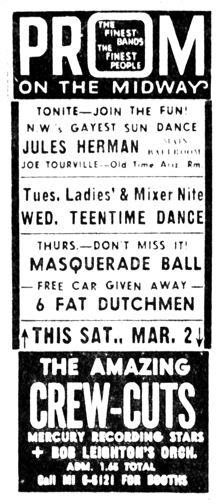
Minneapolis Tribune, Sunday, February 24, 1957
The Four Lads entertained at the Prom Ballroom on Thursday, March 21, 1957.
The Diamonds made a return engagement at the Prom Ballroom on Tuesday, May 7, 1957.
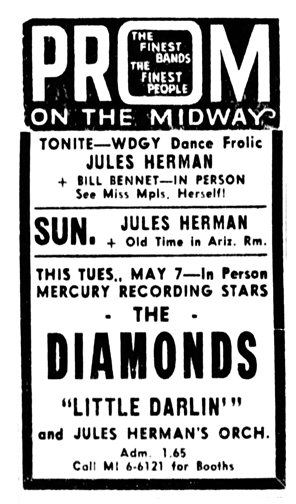
Minneapolis Tribune, Saturday, May 4, 1957
June 29, 1957: WDGY Dance Frolic with Al Noyce’s Band – Bill Bennett as MC.
Buddy Morrow returned to the Prom Ballroom on Friday, July 5, 1957.
The Four Lads performed at the Prom Ballroom on Tuesday, July 9, 1957.
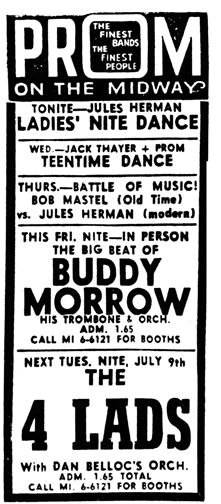
Minneapolis Tribune, Tuesday, July 2, 1957
GENE VINCENT
In an aircheck on www.radiotapes.com, WDGY DJ Bill Bennett said that 1,500 teens attended the Teen Time Dance at the Prom Ballroom the previous Wednesday, and he thanked Gene Vincent. Correspondent Peter Jamieson tells us that the date of the dance was July 31, 1957.
On August 11, 1957, Will Jones remarked on Vincent’s success “in a series of personal appearances in this territory.” Bjorn Skarning was the promoter and hoped to have him back in the fall. Vincent was performing in Mankato at the time.
Stan Kenton and his 20 piece band performed at the Prom Ballroom on Friday, July 26, 1957.
Bill Haley and His Comets performed at the Prom Ballroom at a special Teentime hop on Friday, September 6, 1957. They billed themselves as the “Originators of Rock ‘n’ Roll.” Bill Bennett was the m.c.
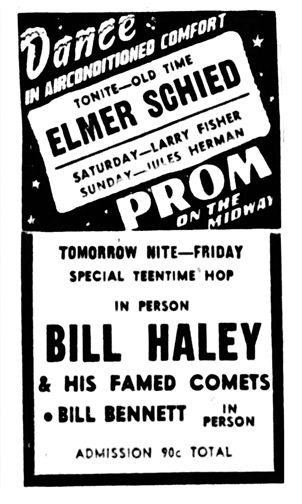
Minneapolis Star, Thursday, September 5, 1957
Nick Nobel and Ralph Marterie came to the Prom Ballroom on Wednesday, October 2, 1957.
The Jimmy Dorsey Orchestra came to the Prom Ballroom on Saturday, October 5, 1957.
Les Elgart, his trumpet and orchestra, provided the music at the Prom Ballroom on Tuesday, October 22, 1957.
True to form, Gene Vincent returned to the Prom Ballroom on Friday, October 25, 1957.
Jerry Lee Lewis shook up the Prom on Wednesday, November 20, 1957 at a Twighlight Teen Hop.
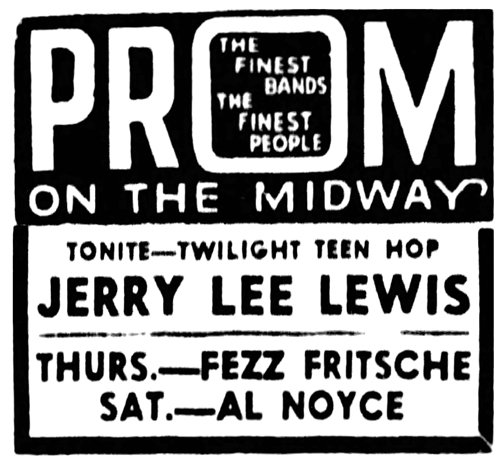
Minneapolis Tribune, Wednesday, November 20, 1957
The Crickets came to the Prom Ballroom on Wednesday, November 27, 1957.
The Four Freshmen returned to the Prom Ballroom on Saturday, November 30, 1957.
Buddy Knox appeared at the Prom Ballroom on Wednesday, December 4, 1957.
1958
The Everly Brothers entertained at the Prom Ballroom on February 12, 1958.
The Four Coins sang at the Prom Ballroom on February 21, 1958.
On Friday, February 28, 1958, the Teen Hop featured Ronnie Sels. This may have been Ronnie Self, a rockabilly singer known for the song “Bop-a-Lena.” WDGY’s Bill Bennett was the MC.
The Four Freshman sang at the Prom Ballroom on Saturday, March 1, 1958.
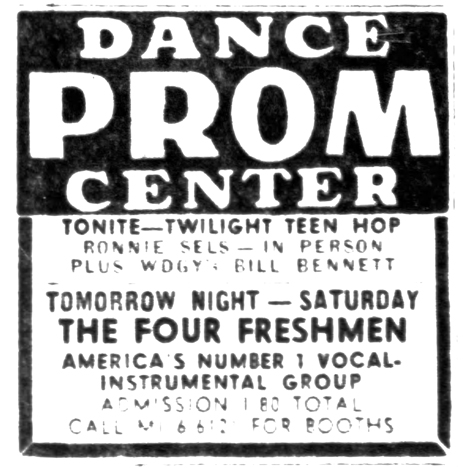
Minneapolis Star, Friday, February 28, 1958
The Royal Teens entertained at the Prom Ballroom on Wednesday, March 19, 1958. This may have been at a Teenage Hop.
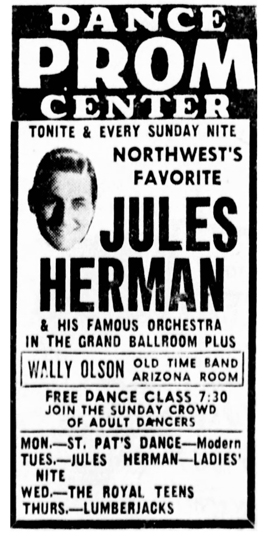
Minneapolis Tribune, Sunday, March 16, 1958
The Four Preps made a return appearance on Saturday, April 5, 1958. Note that the ad cites their big hit as “Twenty Four Miles,” when it was actually “Twenty Six Miles.”
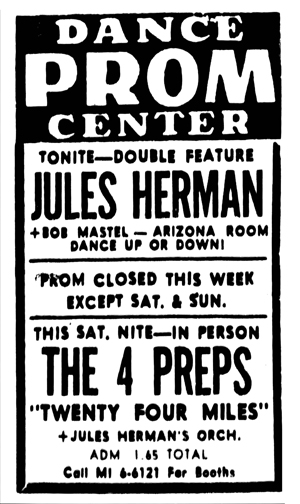
Minneapolis Tribune, Sunday, March 30, 1958
Bill Bennett of WDGY mc’ed the Twighlight Teen Hop on April 11, 1958.
Harry James and His Music Makers – was this the real Harry James at the Prom Ballroom on April 29?
Guy Lombardo came to the Prom Ballroom on May 13, 1958.
The Four Freshmen brought their harmonies to the Prom Ballroom on Tuesday, May 27, 1958.
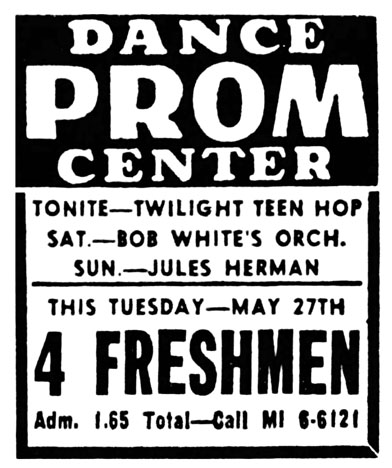
Minneapolis Tribune, Friday, May 23, 1958
May 30, 1958, was the date of another Teen Hop.
Buddy Morrow made a return engagement to the Prom Ballroom on June 3, 1958.
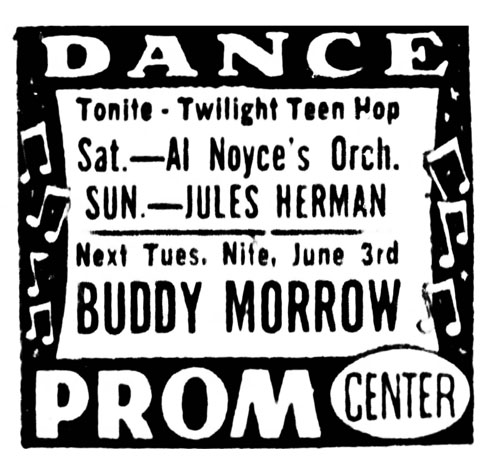
Minneapolis Tribune, Friday, May 30, 1958
The Champs did a stint at the Prom Ballroom on June 5, 1958.
The Tommy Dorsey Orchestra with Warren Covington came to the Prom Ballroom on June 28, 1958.
The Diamonds came to entertain at the Prom Ballroom on July 4, 1958.
The Glenn Miller Orchestra entertained at the Prom Ballroom on July 25, 1958.
A Twighlight Teen Hop was held on Wednesday, July 30, 1958.
The Chordettes entertained on Saturday, August 2, 1958.
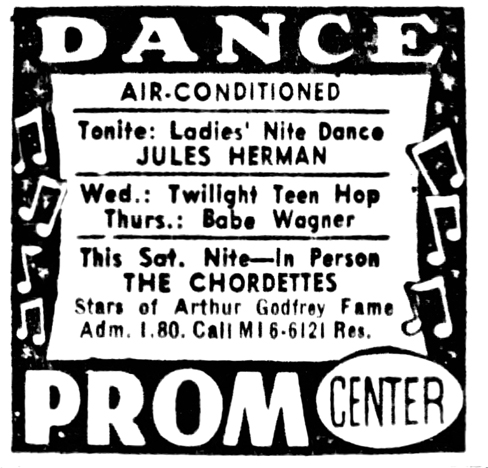
Minneapolis Tribune, Tuesday, July 29, 1958
On Wednesday, August 13, 1958, the Big Beats played at the Twighlight Teen Hop.
On Friday, August 15, 1958, a package show came to the Prom Ballroom, starring:
- Danny and the Juniors
- Gerry Granahan (“No Chemise, Please”)
- Jody Reynolds
- The Poni-Tails
- The Buddy Morrow Orchestra
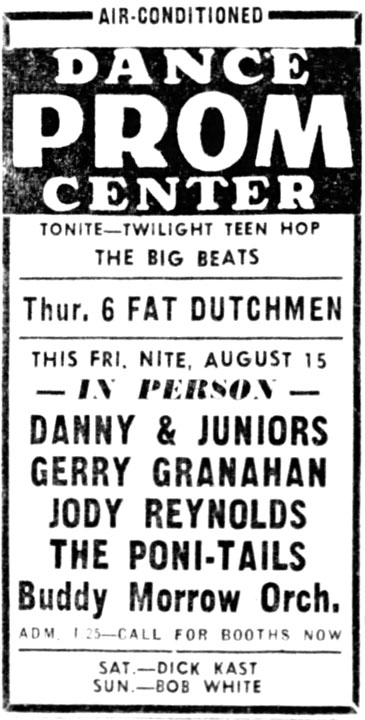
Minneapolis Star, Wednesday, August 13, 1958
The Four Freshmen returned to the Prom Ballroom on August 22, 1958.
On August 20, 1958, the band at the Prom Ballroom was the Big Beats.
Guy Lombardo returned to the Prom Ballroom on September 19, 1958.
What a bill! Gene Vincent and the Blue Caps PLUS Dale Hawkins came to the Prom Ballroom on October 1, 1958! Man!
The Tommy Dorsey Orchestra with Warren Covington came to the Prom Ballroom on October 4, 1958.
Ted Heath and His Orchestra, Direct from England, presented a concert at the Prom Ballroom on October 18, 1958.
A peek at Octoberfest in 1958 at the Prom:
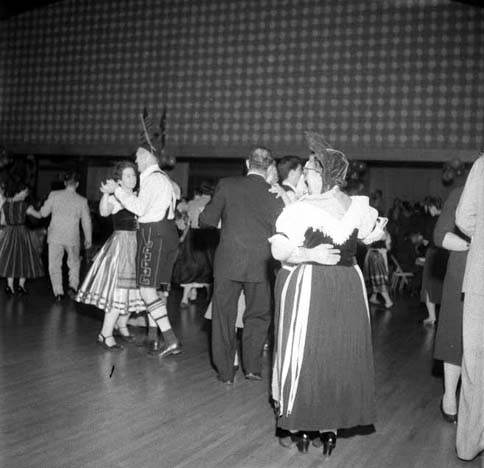
Photo courtesy Minnesota Historical Society
Buddy Knox and Jimmy Bowen entertained the teens at the Prom Ballroom on December 2, 1958.
Conway Twitty got attention when he appeared at the Prom Ballroom on December 23, 1958.
1959
On Wednesday, January 28, 1959, the ill-fated “Winter Dance Party” came to the Prom Ballroom in St. Paul. Read the story on its own page.
A group called Mark IV appeared at the Prom Ballroom on February 25, 1959. They were known for a hugely misogynist song called “I Got a Wife.” Ha Ha.
Bobby Darin and the Bell Notes paid a visit to the Prom Ballroom on March 11, 1959.
The Big Beats entertained at the Prom Ballroom on March 18, 1959.
The Billy May Orchestra, directed by Frankie Lester, provided the music at the Prom Ballroom on April 4, 1959.
SPRING DANCE PARTY
Bill Diehl brought the Spring Dance Party to the Prom Ballroom on Monday, April 6, 1959. What a lineup! Actually, by 1959, rock ‘n’ roll was becoming more of a bunch of novelty songs, but Link Wray made up for the rest.
- The Kalin Twins
- The Bell Notes
- Link Wray and the Ray Men
- Bill Parsons
- Jesse Lee Turner
- All American Boys Band
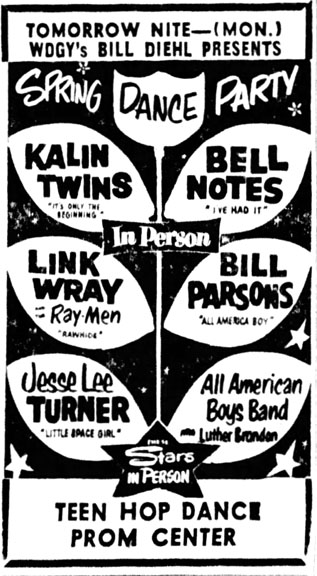
Minneapolis Tribune, Sunday, April 5, 1959
Bill Haley and His Comets played the Teen Hop on Wednesday, April 22, 1959. WDGY’s Bill Diehl was the MC.
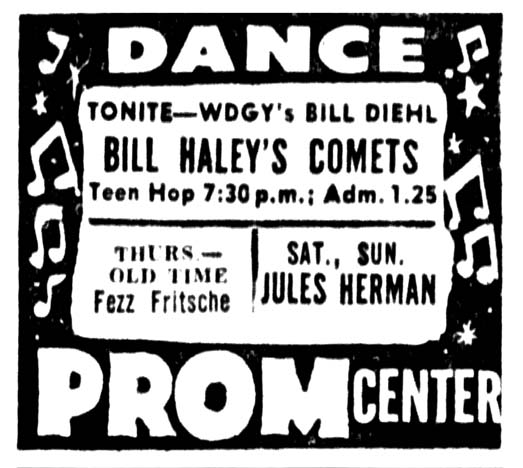
Minneapolis Star, Wednesday, April 22, 1959
The Tommy Dorsey Orchestra with Warren Covington came to the Prom Ballroom on July 10, 1959.
July 13, 1959, brought another package tour to the Prom Ballroom. The ad had a lot of typos and omissions, but I’ll try to list the acts correctly:
- The Addrisi Brothers
- Carl Mann
- The Tassels
- Dicky Doo and the Don’ts
- Jo Ann Campbell
Jimmy Bowen was the Rock ‘n’ roll star on July 18, 1959. His only hit was “I’m Stickin’ With You.”
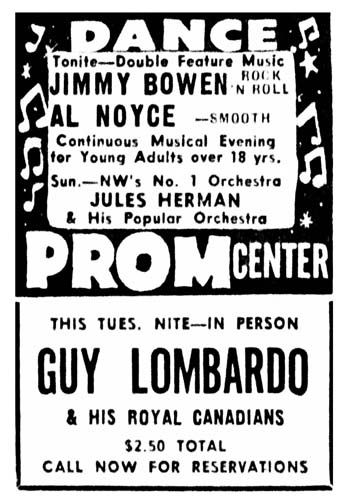
Minneapolis Star, Saturday, July 18, 1959
Guy Lombardo and His Royal Canadians made an appearance at the Prom Ballroom on July 21, 1959.
The Big Beats represented the rock ‘n’ roll portion of the program at the Prom Ballroom on July 25, 1959.
Glenn Miller Orchestra under the direction of Ray McKinley, with original arrangements, played the Prom Ballroom on August 14, 1959.
The Flames, identified as Rock ‘n’ Roll, appeared at the Prom Ballroom on December 26, 1959.
1960
The Champs came back to the Prom Ballroom on January 20, 1960.
On February 24, 1960, the featured artist at the Prom’s Teen Hop was “Mr. Boomerang, Johnny O’Keefe, “Australia’s No. 1 Vocalist.” Although he didn’t catch on here, Wikipedia says
Often referred to by his initials “J.O.K.” or by his nickname “The Wild One,” O’Keefe was the first Australian rock ‘n’ roll performer to tour the United States, and the first Australian artist to make the local Top 40 charts and he had 29 Top 40 hits in Australia between 1958 and 1973.
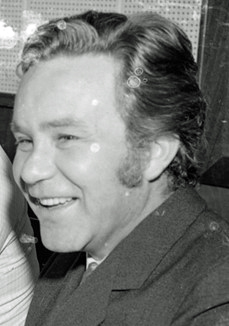
Johnny O’Keefe
The March 4, 1960, Teen Hop at the Prom featured the Glenrays.
MUSICIAN’S BALLS
There must have been two Musicians’ Balls in May 1960. The first one was on Monday, May 16, and featured so-called “Smooth” bands:
- Jules Herman
- Rod Aaberg
- Franke Chermak
- Dick Kast
- The Cherdsmen
- Whoopee John
- Marve Masterman
- Joe Tourville
- Wally Olson
- Red Dougherty
- Chris Kalogersen
- Tony Gruchot’s Brass Band
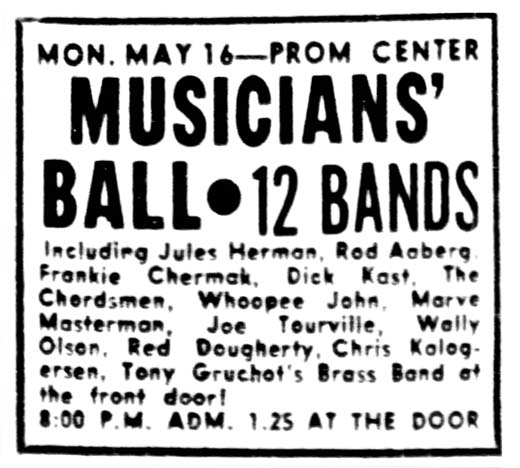
Minneapolis Star, Saturday, May 14, 1960
A Special Teen Hop was held at the Prom Ballroom on Wednesday, May 18, 1960. Bill Diehl was the MC, and the show and featured 12 national artists. (Not all of these guys left a permanent mark on the music scene…) 9 were listed in the ad: (Minneapolis Tribune, Sunday, May 15, 1960)
- Rod Lauren
- Carl Dobkins, Jr.
- Gary Stites
- Dick Caruso
- Johnny Restivo
- Danny Valentino
- Nick DeMatteo
- Harold Dorman
- Johnny and the Hurricanes
May 26, 1960: Cousin Fuzzy and His Country Cousins
May 28, 1960: The Glenrays.
June 4, 1960: The Fendermen
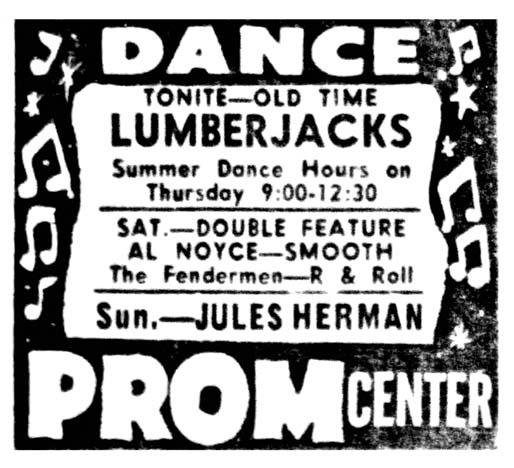
Minneapolis Star, Thursday, June 2, 1960
Tuesday, June 27, 1960: Ralph Marterie Big Band
On Saturday, August 27, 1960, the Glen Rays provided the Rock ‘n’ Roll music, with WDGY’s Bill Diehl as MC.
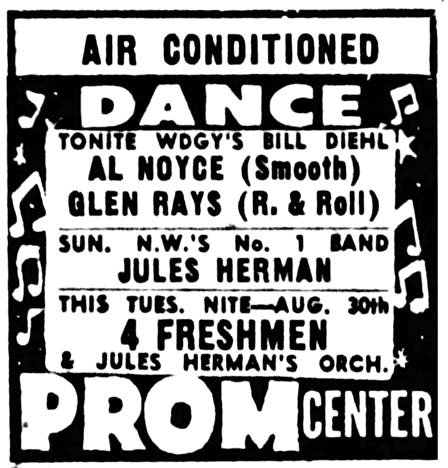
Minneapolis Tribune, Saturday, August 27, 1960
On Tuesday night, August 30, 1960, the 4 Freshmen returned to the Prom, backed by Jules Herman’s Orchestra. Members of the group were Bob Flanigan, Ross Barbour, Ken Albers, and Don Balbour. Each sang and played instruments. (Minneapolis Tribune, August 28, 1960)
On Friday, September 16, 1960, (presumably – the ad is confusing) there was another big Rock ‘n’ Roll show at the Prom Ballroom, featuring:
- Jan and Dean
- The Tree Swingers
- The Ivy Three
- Paul Champlaine
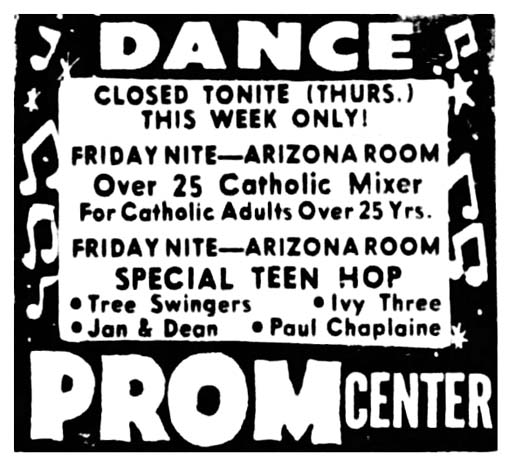
Minneapolis Star, Thursday, September 15, 1960
On Saturday, September 24, 1960, the national group the Flairs provided the Rock ‘n’ Roll entertainment. Bill Diehl of WDGY was the MC. The Flairs, like many groups, had a complicated history, but were generally known for originating the song “Foot Stompin’, which was later became a local favorite by the Underbeats.
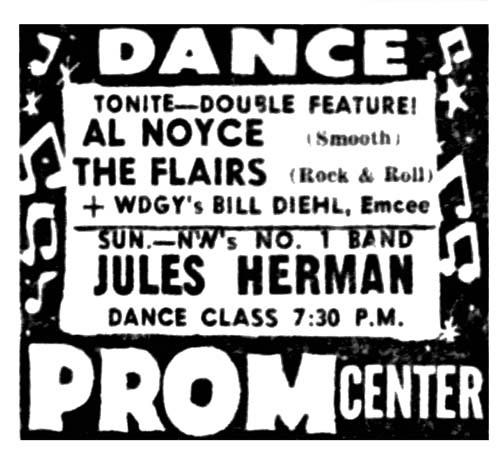
Minneapolis Star, Saturday, September 24, 1960
On November 23, 1960, the Teen Hop at the Prom featured:
- Gene Vincent
- Wanda Jackson
- Buddy White
The Prom’s Teen Hop on December 28, 1960, featured Gene Vincent and the Fendermen.
1961
On January 11, 1961, the Prom’s Teen Hop featured Donny Brooks and the Tornadoes.
On February 1, 1961, Conway Twitty and the Corvets appeared at the Teen Hop at the Prom.
Eddie Randall was the “swing” part of the ticket at the Prom on March 11, 1961.
Eddie Randall’s music was described as rock ‘n’ roll for his appearance at the Prom on April 8, 1961. Bill Diehl acted as MC.
On April 15, 1961, WDGY DJ Bill Diehl MC’d a dance at the Prom starring the Corvettes.
Bill Diehl MC’d a dance at the Prom featuring Rock ‘n’ Roller Eddie Randall on May 13, 1961.
Louis Armstrong performed at the Prom on April 19, 1961.
The Highlights were the rock ‘n’ roll band at the Teen Hop at the Prom, MC’d by Bill Diehl on May 27, 1961.
The Velveteers provided the music at the Prom on June 10, 1961, with Bill Diehl as MC.
The Prom promised a special all-star Teen Hop on June 14, 1961, but didn’t name any of the stars in the small ad.
The Prom’s June 21, 1961 Teen Hop featured both Dion and the Fendermen.
Veteran rocker Mike Waggoner presided over the Teen Hop at the Prom on July 12, 1961.
Mike Waggoner also provided music for the Prom on July 15, 1961. Bill Diehl was the MC.
RECORD STARS DANCE PARTY
An array of stars visited the Prom on October 11, 1961. Acts included:
- Ral Donner
- Ray Stevens
- Tony Orlando
- Bobby Vee
- Janie Grant
The Prom promised a Special Teen Hop on October 25, 1961, but didn’t name any of the stars in the small ad.
Mike Waggoner’s music was described as “Swing” in an ad for their show on November 4, 1961, MC’d by Bill Diehl.
The music of the Corvettes was characterized as “swing” in the ad for their November 11, 1961, appearance at the conservative Prom Ballroom.
Dion was back at the Prom on November 29, 1961, performing with the local band the Little Green Men.
1962
January 3, 1962, was the date of the next Teen Hop at the Prom, with entertainment by Roscoe’s Green Men, and the Velveteers.
Myron Lee and the Caddies put on a wild show at the Prom on January 7, 1962.
Jerry Lee Lewis hit the Prom stage on January 23, 1962.
The Four Seasons, just about to make it big, hit the Prom on January 30, 1962.
Roscoe’s Green Men were back at the Prom on January 31, 1962 for a Teen Hop.
WDGY’s DJ Bill Diehl appeared at the Prom with Mike Waggoner and the Bops on February 24, 1962.
The Corvets performed at the Prom on March 10, 1962.
JOHNNY CASH
Johnny Cash performed at the Prom Ballroom on March 23, 1962. With him were Luther Perkins on guitar and Marshall Grant on stand-up bass.
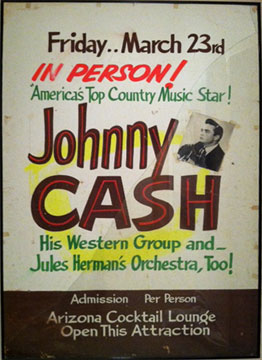
Image courtesy Rich Packer
The Young Peoples’ Dance Club sponsored a Twist Contest, with Mike Waggoner and the Bops providing the music. Prom, March 28, 1962.
Jimmy Dean, backed by the local group the Galaxies, came to the Prom on April 4, 1962, promoting his new record, “Dear Ivan.”
Mike Waggoner and the Bops presided at the Prom on April 14, 1962.
On June 20, 1962, the ad in the Minneapolis Herald read “Young Peoples’ Club Summer Twist Party,” featuring Jay and the Americans.
Skitch Henderson, Musical Director of NBC, appeared at the Prom on June 28, 1962, for a program to celebrate the 100th Anniversary of the Great Northern Railway. At left below with Skitch is John M. Budd, President of the Great Northern.
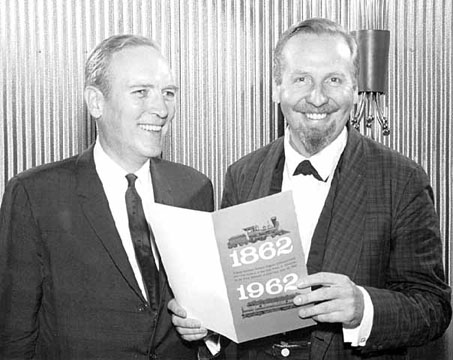
Photo courtesy Minnesota Historical Society
The Corvets were back at the Prom on June 30, 1962.
July 4, 1962, entertainment at the Prom featured the Diablos.
On July 6, 1962, the Dukes of Dixieland (not exactly rock) countered the smooth at the Prom.
GALAXY OF STARS
On August 8, 1962, KDWB sponsored a Hop featuring:
- Bobby Vinton
- Gene Pitney
- Gary Criss
- The Bachelors
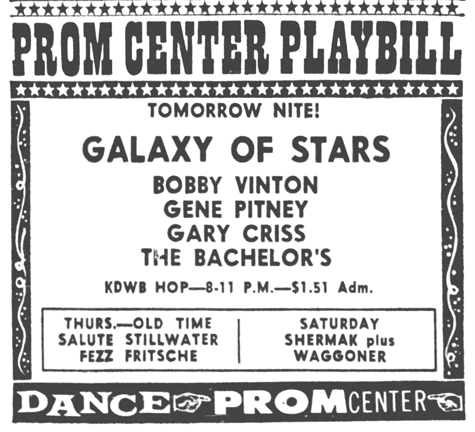
A KDWB Hop featured DJ Hal Murray and singer Johnny Tillotson on August 29, 1962, at the Prom.
A KDWB Hop on September 12, 1962, featured Johnny and the Galaxies.
The rock act for September 15, 1962, was listed (in small letters) as “Dal Winslow, New Sensation.” This was the nascent Trashmen, but the Prom management was hesitant to book a band with such a far-out name, so member Winslow was put up front as a teen crooner, and later orchestra leader.
Mike Waggoner and the Bops provided the rock music on October 13, 1962, at the Prom.
Conway Twitty paid a visit to the Prom on October 24, 1962.
Mike Waggoner played a show at the Prom on October 25, 1962.
The Velveteers take over the rock ‘n’ roll duties at the Prom on October 28, 1962.
On November 21, 1962, Joey Dee and the Starlighters came to the Prom – at the height of their fame as revivers of the Twist.
Maynard Ferguson performed at the Prom on December 12, 1962.
Bobby Vinton paid a call to the Prom on December 13, 1962.
The Corvets returned to the Prom on December 15, 1962.
1963
In 1963 the Prom was usually sticking to its formula of having one rock band and one “smooth” band each night. A frequent local rock band was the Corvets; another was the Galaxies and Tim. During the summer there was usually a name band on Wednesday nights, for only 90 Cents admission. Normally I don’t do band pictures, but this one came up on Facebook; the Corvets, in a ’63 Corvette at Polar Chevrolet in White Bear Lake. The band was anchored by Eddie and Norm Barkdoll, also from White Bear Lake.
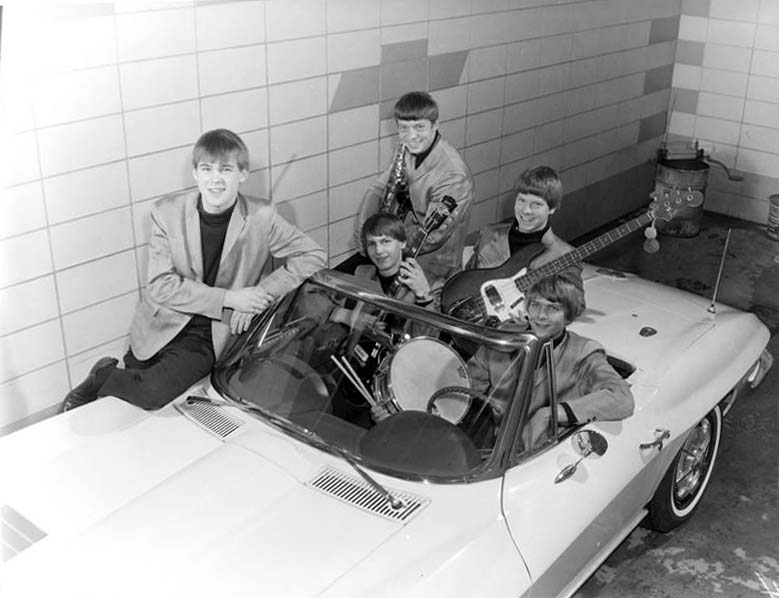
The Corvets in a Corvette, 1963
A January 2, 1963 “Vacation Hop” at the Prom featured Bobby Vinton.
Mike Waggoner and the Bops – the “Busiest Band in Town” – played the Prom on January 12, 1963.
The Trashmen, billed as a New Sensation, was the band for Swingin’ Saturday at the Prom, January 19, 1963.
Jerry Lee Lewis tore up the Prom on January 23, 1963.
The Corvets performed on January 26, 1963, at the Prom.
The Four Seasons and our own Trashmen combined forces on January 30, 1963, at the Prom.
In February 1963 the Prom was advertising Bossa Nova classes: “You might meet the most important person in your life!”
February 9, 1963, introduced the Startones to the Prom.
Dion, plus the Corvets, graced the Prom’s stage on February 13, 1963.
Johnny Cash came to the Prom on March 29, 1963.
April 10, 1963, was the date of the Spring Vacation Show and Dance, starring Conway Twitty, Brian Hyland, and Mike Waggoner. Acting as M.C. was WDGY’s Red Jones.
The Galaxies and Tim, billed as the “Great New Galaxies,” entertained at the Prom on May 4, 1963.
Joey Dee and the Starlighters, with Danny and the Diamonds, came to the Prom on May 8, 1963.
May 9, 1963, featured the Blue Banners at the Prom.
Mike Waggoner and the Bops carried the hall on May 11, 1963.
The Trashmen played the Prom on May 18, 1963.
KSTP presented Stan Kenton at the Prom on May 29, 1963.
Spring Shower of Stars, May 31, 1963:
- Paul and Paula
- Steve Alaimo
- Lou Christie
- Johnny Cymbal
- Ronnie Cochrane
- Charlie Russo
- Extra Added Attraction: Dick and DeeDee
Here’s an interesting tidbit – a letter of support for the band written by Dick Clay, the manager of the Prom. In it, Clay says that the Trashmen had been playing at the ballroom once a month for over a year.
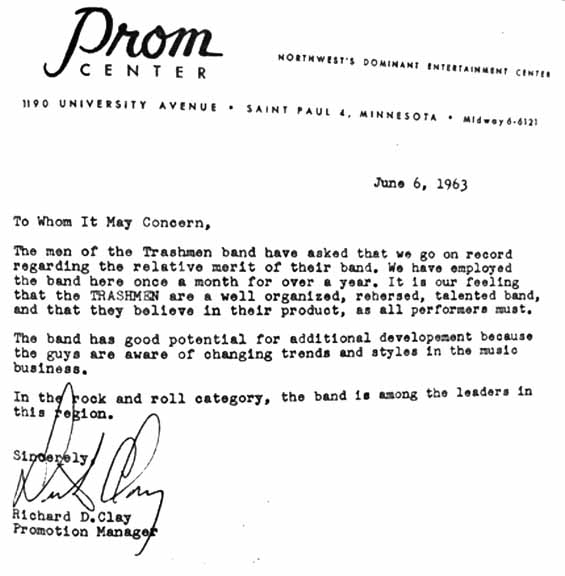
Image courtesy David Klint
Mike Waggoner and the Bops, “The Northwest’s Busiest Rock Band,” played the Prom on June 8, 1963.
The rock band on June 15, 1963 was the Startones.
The Dovells (“You Can’t Sit Down”) and Eddie Randall made an appearance at the Prom on June 26, 1963.
The Cascades, July 3, 1963
Bill Miller (perhaps at DJ?) and the Accents showed up for the Coca Cola Teen Fling on July 10, 1963.
Les Elgart, July 12, 1963: “KSTP Invites You”
The “Roaring” Trashmen and the Bob White Orchestra, July 20, 1963
The Beach Boys hit the Prom Ballroom on August 2, 1963.
Little Peggy March (with the Warner Brothers Band), August 7, 1963
Johnny Cash, August 21, 1963
Lou Christie, Brian Highland, Ronnie Cochrane, and the Casuals all descended on the Prom on August 30, 1963 (all for $1.49!)
Lonnie Mack (“Memphis” and “Wham”) performed at the Prom on September 14, 1963.
September 28, 1963, saw a return of the Corvets at the Prom.
Mike Waggoner and the Bops made a regular visit to the Prom on October 12, 1963.
On October 29, 1963, the rock band at the Prom was the fabulous Embers.
On October 26, 1963, the Prom promised new sounds from the New Corvets.
November 9, 1963, featured Mike Waggoner and the Corvets in a two-band “Whing-Ding.”
Jimmy Gilmer and the Fireballs (“Sugar Shack”) made their way to the Prom on November 12, 1963.
November 16, 1963, was the premiere of Patty Lynn and the Shamrocks at the Prom.
The Corvets returned to the Prom on November 23, 1963.
On November 27, 1963, WDGY sponsored a “Rock vs. Rock” event with the Galaxies & Tim vs. Patty Lynn and the Shamrocks.
December 11, 1963, was the Marines’ Toy Dance, with the Uniques, the Blackouts, and the Continentals. Admission was a toy worth $1.00.
The Kingsmen were advertised for December 28, 1963, at the Prom. The Galaxies were in the Arizona Room.
The Galaxies and Tim entertained on New Year’s Eve in the Arizona Room of the Prom, December 31, 1963.
1964
January 4, 1964, featured rock regulars the Galaxies & Tim.
January 11, 1964, featured Twin Cities rock stalwarts Mike Waggoner and the Bops.
On February 1, 1964, Dick Arthur was advertised as a fine new six-man “rocker.”
On February 8, 1964, the Prom presented the Caravelles, who had the hit song, “You Don’t Have to be a Baby to Cry.” Really, it was a hit. They were a British duo. The other rock act that night was the Counts Four.
The fabulous Embers, a band from St. Cloud, provided the rock on February 15, 1964.
On March 7, 1964, the Kingsmen were advertised ahead of time, but the Galaxies with Tim McManus was advertised on the day.
On March 21, 1964, the rock act was Lee James.
Two singing duos, Nino Tempo and April Stevens (“Deep Purple”) and Dale and Grace (“I’m Leavin’ it all up to You”) appeared on March 25, 1964. Also appearing were Jack McManus and the Belmonts.
On April 4, 1964, the Fendermen appeared at the Prom.
On April 11, 1964, the rock ‘n’ roll band was the local Ravons.
Bobby Vinton appeared at the Prom Ballroom on April 15, 1964. Also on the bill was local group Tim and the Galaxies.
On May 9, 1964, it was the “Wild and Wonderful” Trashmen!
May 16, 1964, greeted Patty Lynn and the Shamrocks.
June 20, 1964, brought the reliable Corvets. Not Corvettes – that was a car.
July 25, 1964, brought back the Counts Four for your rock dancing pleasure.
THE EVERLY BROTHERS
On July 29, 1964, the Everly Brothers appeared at the Prom, opened by the Castaways. Jim Donna described the night in his book, Liar, Liar: The Story of Minnesota’s Castaways in the 1960s.
We were set up on the stage side by side with The Everly Brothers. The Castaways opened the show at 8:00 p.m. to a packed dance floor. Some of our best songs were by The Everly Brothers, and we always played them at our teen dances. So, we thought why not play them tonight? We proceeded to play some of The Everly Brothers’ most popular songs during our opening set, with Roy and Bob harmonizing nicely on the vocals. After we finished our set, we realized that we shouldn’t have done that! We were just kids, with most of the band members still in high school, and we didn’t know any better. I believe that Denny Craswell, our drummer, was just 16 years old at the time.
Backstage after the show, Don and Phil Everly told us that they really enjoyed hearing us playing their songs, and everything was OK. That was really reassuring to hear. Don and Phil were some of nicest musicians I have ever worked with. This was one of my all-time favorite gigs during my time with The Castaways. The Prom Ballroom paid us $125.40, union scale. Dick Clay, the manager, had a big smile on his face as he handed us our check.
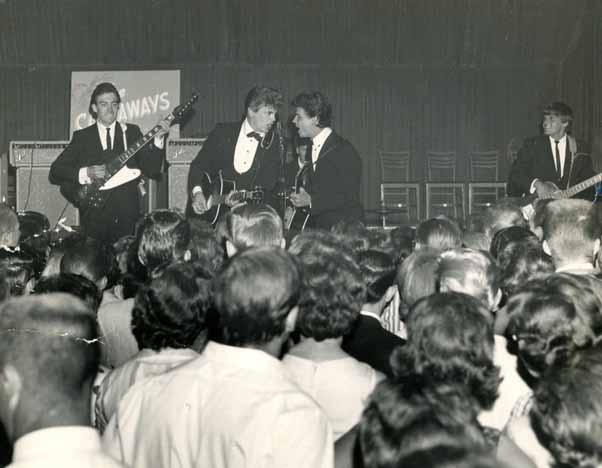
Photo courtesy Jim Donna
On August 1, 1964, the rock act was the Galaxies.
Mike Waggoner and the Bops returned on August 15, 1964.
Count Basie appeared at the Prom Ballroom on August 19, 1964.
August 22, 1964, saw the exciting Jades at the Prom.
The famous Accents, one of the most popular local bands, performed at the Prom on August 29, 1964.
Something called “The” Band was the rock half of the bill on September 5, 1964.
Lonnie Mack appeared at the Prom on September 12, 1964.
Mike Waggoner and the Bops came back on September 19, 1964.
On October 10, 1964, the Fendermen came to the Prom, billed as the Cadillac of the fabulous rock bands!
Harry James, Buddy Rich, and Ruth Price were at the Prom on October 16, 1964.
Gregory Dee and the Avanties provided the Rock on October 27, 1964.
Roger Miller performed at the Prom on October 21, 1964.
The Trashmen prevailed on October 24, 1964, at the Prom.
On October 30, 1964, the ad read “New Policy!” The group Richie and the Jades were labeled “Sophisticated Rock.”
Mike Waggoner and the Bops played the Halloween dance on October 31, 1964.
On November 7, 1964, the Accents again took the Prom stage.
On November 26, 1964, WTCN-TV’s “Polka Jamboree” show, starring Tony Jambor and Stuart A. Lindman, was filmed at the Prom. “See yourself dancing on TV next Sunday!”
DEL SHANNON
Del Shannon appeared at the Prom Ballroom on November 28, 1964. Also appearing were rock ‘n’ roll mainstays, Mike Waggoner and the Bops.
Roland Anderson and his sister Marilyn, who Roland describes as a “Del Shannon nut,” were there. Roland has graciously shared his diary entry for that evening with us:
Tonight will be one of the greatest memory nights of all time. At 9:40 Marilyn and I got up to the front of the stage and when Mike Waggoner introduced him and Del Shannon came out on the stage we were only about 6 feet away. He sang Runaround Sue, Hats Off to Larry, Crying, Little Town Flirt, Keep Searchin’ (his new one), Handyman, Runaway and then Keep Searchin’ again. Seeing Del seemed like it would have felt to see President Kennedy. It just didn’t seem real. While Del was resting back stage I bought pop for everyone.
Before Del came out again, Marilyn and I got right in front of the microphone at 11:00. While there, Del Shannon walked by right in back of us and I told Marilyn to et his autograph. First he just happened to walk by and then he happened to stop so Marilyn could get his autograph. She had brought a blown-up picture of Del playing a guitar and when she asked him to sign it, he said that picture was taken in England. Marilyn told him she had all of his records and he put his arm on her and said “good girl” and asked her how she liked Keep Searchin’. I’d pay $20 bucks to have a picture of that moment. Everyone else was so unconcerned. No one else was around when she was getting the autograph.
When Del was singing again, he sang Twist & Shout, Hats Off to Larry, Runaway, Handyman, Keep Searchin’ twice more and Do You Wanna Dance? He said that everyone should buy his new record so he could pay his income tax. All this time we were practically breathing on his shoes. When we left at 11:45 we saw Del in a hall with an old grey jacket on signing an autograph. When home we had cocoa.
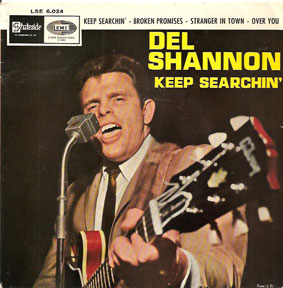
Conway Twitty entertained on December 26, 1964.
HOLIDAY HOP
The December 30, 1964 Holiday Hop at the Prom featured:
- Chad and Jeremy
- Bobby Goldsboro
- Ronnie Cochrane (“Guitar Man”)
- Ronnie Dio and the Prophets Band
Jim Froehlich gives us this great information on that last, seemingly obscure, band:
Ronnie & the Prophets evolved in the late ’60s to a harder rock sound, becoming first “The Electric Elves,” then “The Elves,” and eventually in 1972, just “Elf.” [They opened for Deep Purple’s Burn Tour on December 9,1974, at the Met Center.] Elf was eventually absorbed into Ritchie Blackmore’s post-Purple project Rainbow in 1975. Dio went on to front Black Sabbath and then embarked on a memorable solo career. From doo-wop to “Holy Diver” in less than 20 years… 😉
R.I.P. Ronnie James Dio.
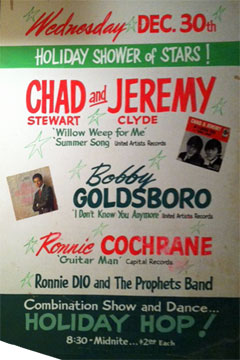
Poster image courtesy Rich Packer
1965
In the mid ’60s the Prom featured rock bands on Fridays and both rock and big bands on Saturdays (“rock vs. smooth”).
Bob Reed’s journal shows the Trashmen performing at the Prom Ballroom on February 27, 1965.
Count Basie, March 24, 1965
Something called the Whisky a’ Go Go Show was at the Prom on June 18, 1965.
The Everly Brothers were at the Prom on July 21, 1965.
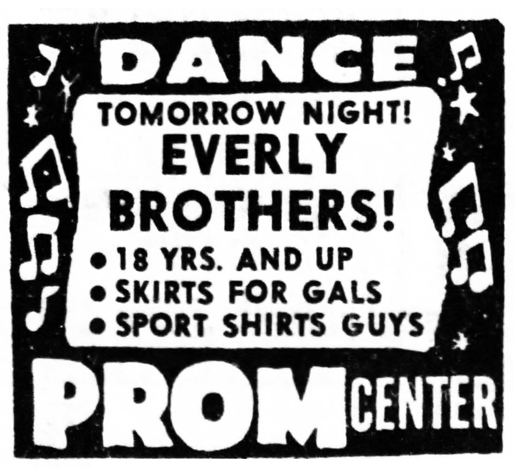
Minneapolis Star
Dee Dee Sharpe and Dick & Dee Dee, August 11, 1965. Dee Dee Lee/Sperling was born in Minneapolis. They were backed by the Daze and Knights, a group that was “half colored, half white.” Roland Anderson shares his journal account:
Twelve fans pack Prom Center!
Shari and I left for the Prom Center tonight at 7:20. When there, just before 8:00 I thought it would be packed but only about ten others were showed up! When inside we reserved a real good booth. The band playing was called the Daze & Knights. When Dee Dee Sharp was out, her best song was “Mashed Potatoes.: Dick & Dee Dee were real good. They sang “The Mountain’s High,” “Thou Shall Not Steal” and when they sang “Turn Around” we danced. [This would have been the first time we ever danced in public.] We left at 11:15 so we didn’t get to see Dick & Dee Dee’s second appearance.
The Strangeloves and the McCoys, August 25, 1965. At the time the Prom was featuring rock bands on Fridays, and both a rock band and a big band on Saturdays.
The Sir Douglas Quintet, September 10, 1965.
The Trashmen played the Prom Ballroom on September 24, 1965.
Billy Joe Royal, October 8, 1965. Attendance was low because there were a lot of homecomings that weekend. Backing him were local act the Marvelous Marauders.
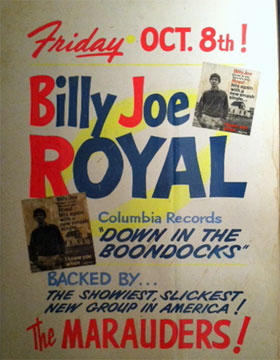
Poster image courtesy Rich Packer
The Flippers were on a roll, performing at the Prom on December 30, 1966. The Marauders were also on the bill, says Marauder Jerry Cadwell.
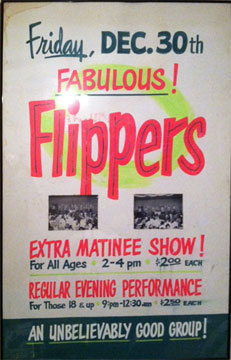
Poster image courtesy Rich Packer.
1967
The Turtles played the Prom on May 3 and August 16, 1967.
Tommy James and the Shondells played the Prom Ballroom in June 1967.
The Casinos, a 9 man vocal group from Cincinnati, appeared at the Prom in June 1967.
The Turtles returned to the Prom on August 16, 1967.
The Everly Brothers played the Prom on October 6, 1967. Also Chicago’s The Mob, and the Cities’ System.
1968
John Fred and His Playboy Band appeared at the Prom on March 27, 1968.
1969
Woody Herman, February 5, 1969
1970
1971
In 1971 the Old Guard was grousing about the changing tastes in music. The St. Paul Musician, house organ for the St. Paul Musician’s Union, tried to make sense of it:
Some of our members who keep telling me that rock music is on the way out must be less than naive if the record crowds of over 25,000 customers who shelled out about $7.00 each to attend the recent rock concerts at Midway Stadium is any indicator. Hot or rainy weather, discomforts, and still they pack them in. On the other hand bands like Woody Herman or Count Basey [sic!] who are tops in the field of jazz, play The Prom in concerts can’t seem to draw more than 800 people at box office prices substantially less than at midway Center. It all adds up that the kids still want their favorite rock bands.
1973
Stan Kenton’s 19-piece big band appeared at the Prom on April 18,1973, and Star reviewer Tom Murtha just loved it!
The Prom was still featuring big bands, with Buddy Rich (“Mr. Nice”) on May 9, 1973.
Harry James, or at least his band, appeared at the Prom on June 7, 1973.
Maynard Ferguson graced the stage at the Prom on October 10, 1973.
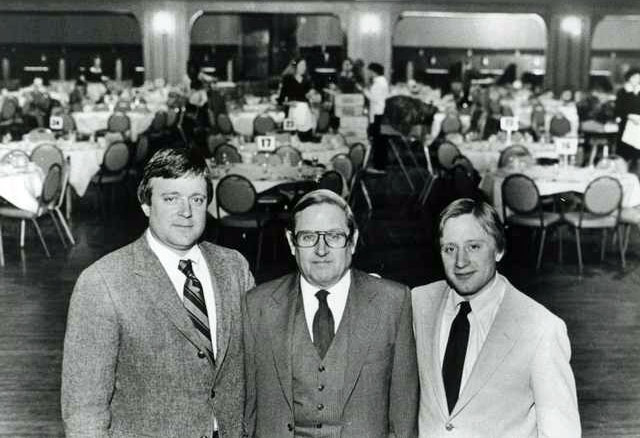
Tom, Harry, and Bill Given, owners of the Prom Ballroom, 1975. Photo courtesy Minnesota Historical Society
THE END OF THE PROM
The eminent demise of the Prom was reported in the Strib on June 17, 1986.
Tom Given said that he and his father, Harry S. Given, Jr. were negotiating to sell the building to a new owner that would probably tear it down. The family planned to move their thriving catering operation to a new location, preferably in the Midway area.
Harry Given said that the dance hall business began to decline in the early 1950s, “when a trend toward earlier marriages cut short the courtship process and television gave the younger married couples a cheaper entertainment alternative,” reported the Strib. Given recalled, “It used to be a guy could spend a buck-ten and hold his girl in hiss arms for three hours.”
By the mid 1960s, public dancing was confined to Sunday night. The decline was offset by a booming catering business that generated about $3 million in 1985. As long as most of the catering business was on-site, it made sense to carry the costs of the ballroom. But when 80 percent was off-site, it didn’t make economic sense, and the family put the ballroom up for sale in 1983.
The last night at the Prom was April 17, 1987. Entertainment was provided by Cab Calloway himself, accompanied by Ted Unseth’s American Classic Jazz Orchestra. Also appearing were Shirley Witherspoon and Prudence Johnson. The show was emceed by Leigh Kamman.
On April 29, 1987, an auction was held, with everything in the building up for sale.
Prom Ballroom napkin holders rescued from the wrecking ball; photo courtesy Barbara Kartarik Nelson.
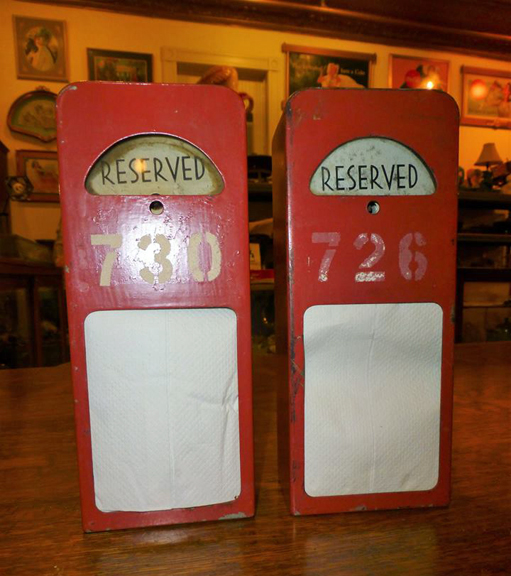
One booth went to the Minnesota Historical Society’s permanent collection. Others went to a burger joint called Shantytown in Bloomington. Sorry my pictures aren’t so good:
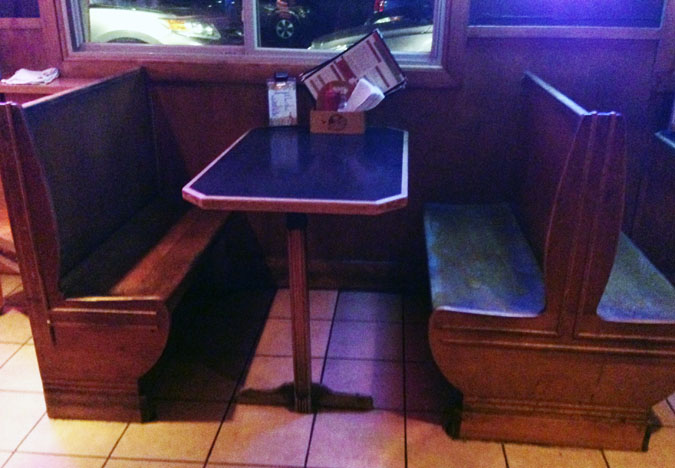
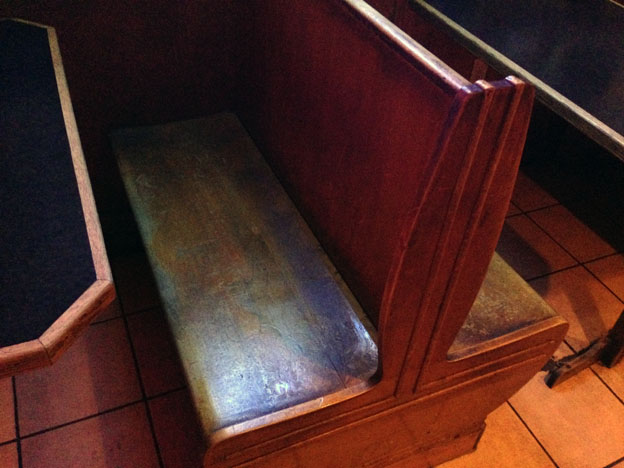
Len Barry
Gary US Bonds
Johnny Burnett
The Byrds
Freddy Cannon
Chubby Checker
Jimmy Clanton
Mike Clifford
Eddie Cochran
Billy Crash Craddock
The Crests
Dave Dudley
Paul Evans
Johnny Ferguson
Frankie Ford
The Four Seasons
The Hollies
Brian Hyland
Jay and the Americans
Dickey Lee
Johnny Maestro
The Mystics
The Newbeats
Floyd Robinson
Tommy Roe
Bobby Rydell
Santo and Johnny
Jack Scott
Skip and Flip
Johnny Tillotson
The Tokens
The Ventures
The Vogues
Jerry Wallace
Save
Save
Please see The City.
Pudge’s Cocktail Lounge and Supper Club opened on October 15, 1968, underneath the Lucky Lanes Bowling Alley at 2155 Ford Parkway (at Cretin) in Highland Park, St. Paul.
The bowling alley had opened in 1953 with 16 lanes; 8 more were added in 1958.
“Pudge” was Kit Hymanson, who opened the place at the tender age of 25. Pudge also/eventually owned the bowling alley as well, with his brother Dennis S. Hymanson.
In December 1969, thanks to a report of a robbery, we learn that the manager’s name was Ron Lancett. Details of that incident were sketchy, with reports of the take ranging from $6,500 to $8,000 to $25,000. Also, did Pudge get hit on the head once or four times by the robber? Were there two or three of them? And first reports gave Ron’s name as Robert. Take your pick!
One thing we do know is that in 1969 the club had jazz jam sessions on Sundays, and on the night of the robbery the place was filled to capacity (the paper said 400 people), which is pretty good for jazz. In 1970, the Bobby Lyle Express was a frequent entertainer.
The rest of the week the club featured local rock groups; some of them mentioned in the paper were Sterling, Kalidescope, and Sterling. Fans especially remember two of Jiggs Lee’s bands, Cain and Fragile.
The club was remembered by “Drink and Sink” Monday nights: for a $3.00 cover, drinks were a dime!
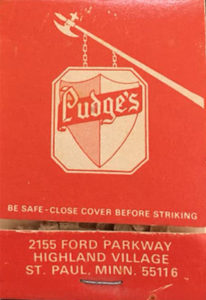
DISCO DAYS
Disco hit town and Pudge’s was right there with lessons, light shows, and a stainless steel dance floor. Here’s a combination dance exhibition/fashion show put on by Powers at Pudge’s:
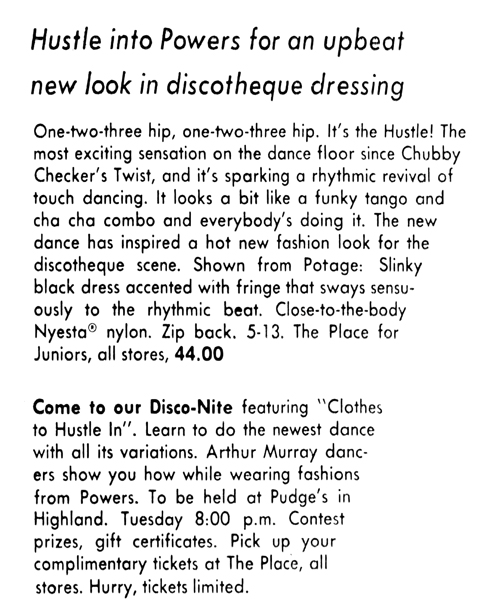
More on this when I read the articles…
ALL THINGS MUST PASS
In 1973 the drinking age was reduced to 18. Pudge’s eventually became maybe too popular, served too much alcohol, and its patrons became too rowdy – if not in the bar, in its environs. All sorts of bad behavior was making the neighbors angry, from public urination, public copulation, littering, fighting, window-peeping, and just plain late night noise. Police were called to the club, and finally the jig was up.
On August 11, 1982, the St. Paul City Council revoked the liquor license of Pudge’s, effectively putting it out of business. Pudge claimed that this action would wipe him out – with no liquor license he couldn’t sell the place, and he estimated a potential loss of $500,000. He took the action to the Ramsey County District Court for review of the decision. A temporary restraining order allowed the club to stay open while the action was reviewed. On October 15, 1982, the Court upheld the Council’s decision, ruling that the Council’s action “was not arbitrary or capricious and was supported by substantial evidence.” Pudge’s attorney appealed the decision to the Minnesota Supreme Court.
But before the Minnesota Supreme Court reached its decision, tragedy struck. On November 10, 1982, Pudge, still only a young man at 39, was found dead at his home on Kenwood Parkway. The autopsy determined that he had committed suicide by ingesting two kinds of barbituates. He lived alone and his belongings were sold at an estate sale.
On January 24, 1983, the Minnesota Supreme Court upheld the decision of the lower court. The club had to close.
Pudge’s legacy, the club that had meant so much to so many young people for the past 14 years, closed as its liquor license expired on January 31, 1983. Lines were long that January day as people waited in line to get in for their last chance to see the site of so many adventures. From the comments on Facebook, there must be thousands of people out there with fond memories of “Drink and Sink,” Cain, and those disco nights. Let’s lift our glasses and drink a toast to Pudge.
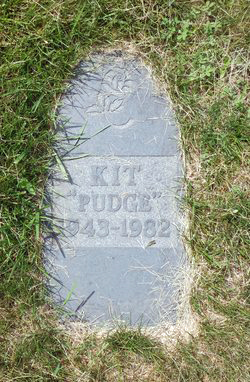
The bowling alley stayed open until 1985. The building is now owned by Fairview.
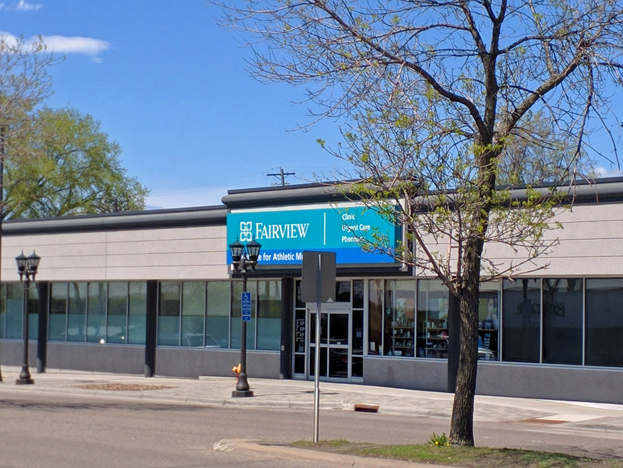
2016 Photo
Save
Puff the Magic Dragon was a large anchored barge on the Mississippi river with a stage on it, and bands and played to people on land. It was anchored at the Svoboda Boat Works, 1835 S. Mississippi River Blvd., under the W. 7th Street Bridge in St. Paul (near Hidden Falls, say people on Facebook). Puff was the brainchild of Bill Svensson and his brother Paul, both of Golden Valley.
BILL SVENSSON
William A. Svensson was born in 1940 and was a championship swimmer from a young age through his high school years at West High. He served on submarines in the Navy from 1957 to 1961.
In 1963, Bill, 22, and his brother Paul, 18, bought the former Pylon drive-in on Highway 12 (6224 Wayzata Blvd.), spread sand around, and renamed it the Beachcomber. Unfortunately, Bill paid the $25 food license and the $6 cigarette license with a bad check, and was hit with a $100 fine, not to mention 30 days for driving with a suspended drivers license.
Before he embarked on his Puff adventure, he was variously described in newspaper reports as a restaurant designer and a designer of pool areas in apartment complexes.
He began building his boat in about April 1970 in Osceola, Wisconsin, and had it towed to its location across from Fort Snelling in late May. He told reporter John Greenwald of the Minneapolis Star that he had wanted to make a trip down the Mississippi River for about ten years, and, at age 30, this was the time.
PUFF WAS A BIG DRAGON
Puff would feature a dragon’s head in front and a tail behind. The pink and purple craft would ban drugs, but “three kegs of beer will be going 24 hours a day.” Svensson planned to begin his trip to New Orleans by July 1, 1970 and reach his destination in a month, stopping each night at marinas so that performers on board could perform for crowds that would gather. 80 people would make the trip, each a shareholder. (Minneapolis Star, June 10, 1970)
Puff was further described as:
a kind of an ark about [80] feet long being built with 55-gallon empty oil drums underneath and full beer kegs on the two upper decks. The bearded gentry doing the constructing near Ft. Snelling said the craft will be floated down to New Orleans with the help of four 120-horsepower engines. There will be numerous riverbank stops during with entertainers aboard will perform numbers from “hair” and “Oh, Calcutta.” (Minneapolis Star Letter from home, June 15, 1970)
The boat had three levels: couches on the first floor, berths on the second, and the stage was on the top. The structure supposedly weighed 30 tons.
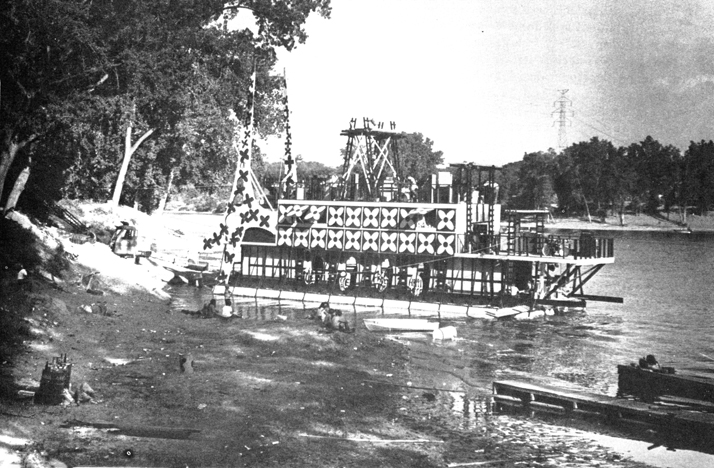
Photo from Connie’s Insider, August 1, 1970. Copyright Mike Barich, St. Paul.
ROCKFEST
The first musical event on Puff was to be a Rockfest held at Harriet Island on July 10 and 11, 1970, featuring scenes from “Hair” and music by nine bands, including The Mystics. Tickets were $3.50. Well, the first outing was a disaster, as reported by Will Shapira. As Puff was being moved to Harriet Island several miles downstream, it got stuck on a sandbar at the Boat Works. A tugboat and a crew of volunteers finally got Puff freed at 10:15 pm, and the wet but still enthusiastic volunteers got in their cars and headed to Harriet Island. Puff puffed in at 11:45, only to find that the bands had either played or left, and the audience gave up the ghost. Not to be discouraged, Puff”s house band, appropriately called The Noise, gave a short set. Hopefully Puff got home all right. (Minneapolis Tribune, July 12, 1970)

Minneapolis Tribune, July 5, 1970
JULY 24 – 26
The second concert was on July 24 – 26, 1970, where Puff was tied to the Svoboda Boat Works.
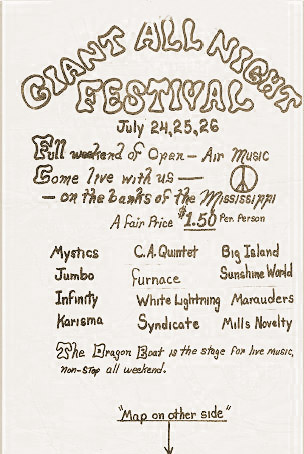
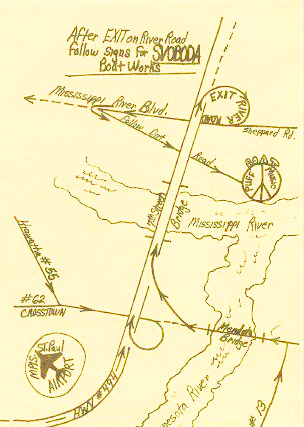
This three-day music festival was not well received by the residents living in the Highland Park and W. 7th Street neighborhoods, according to the Star, which reported that a half dozen rock bands were still playing at 6 am on Sunday morning, and police and the City Council had had enough of the noise. And the pot smoking in the churchyard. And the lovemaking on the riverbanks. And the illegal parking on Mississippi River Blvd. etc. etc. etc. So when the Svenssons requested a license to hold another concert for the upcoming weekend, “the license committee today nixed the idea” and alerted them to about a dozen ordinances and state laws that were broken. (Minneapolis Star, August 6, 1970)
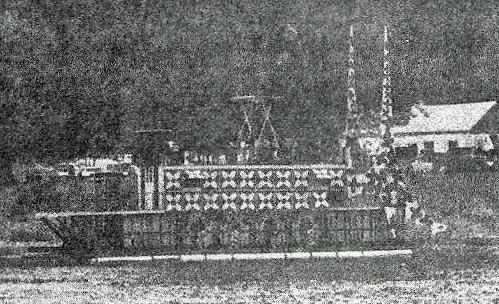
Photo courtesy St. Paul Pioneer Press
Will Shapira reacted to similar bad press in the St. Paul Dispatch, calling it ridiculous. He said that more than 3,000 people attended the 3-day event and there was no trouble of any kind. (Another estimate was 2,000.) Residents polled said they were able to sleep with their windows open, young boys were hired to clear away the trash, and the St. Paul cops didn’t hassle anyone. And besides, “is it really a civic problem if a couple makes love while grooving to music? Is this the concern of government?”
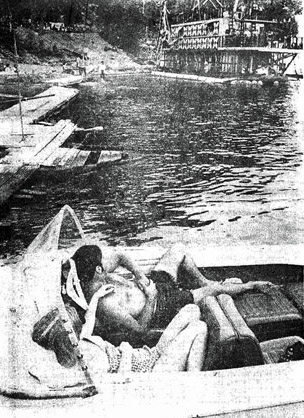
Photo courtesy St. Paul Pioneer Press
Apparently Bill Sumner of the Dispatch also had the audacity to accuse the bands of being “second rate.” Shapira responded, “This simply was not true; among those performing were The Mystics, White Lightning and a dozen other of the top local groups. Anyway, how would Sumner know? The scene impressed even such highly regarded musicians as Three Dog Night. According to a witness, Three Dog Night visited Puff intending to stay a half hour but wound up jamming with The Mystics for something like four hours!” (Three Dog Night was in town on July 12….) (Connie’s Insider, August 1, 1970)
AUGUST 14 -16
A third concert took place on August 14-16, 1970, after negotiations with St. Paul police. Music would commence at 8 and stop at 3 am, cars would be parked at the bottom of the riverbank instead of on the street, and off duty police would be on hand for crowd control. Bill Svensson said he believes people “were more afraid of what might have happened because of bad publicity of other such festivals than of what actually happened.” (Minneapolis Tribune, August 13, 1970)
Flash Tuesday, White Lightning, and the Mystics were some of the bands that played at this concert, which drew a reported 4,000 people. Svensson estimated that about 200 people stayed overnight. It was at this point that he admitted that “I’ve always liked music, but my real interest is in housing. This boat is really a commercial prostitution on purpose – to get the press I’ve been getting.” (Minneapolis Tribune, August 19, 1970)
OTHER CONCERTS
According to calendar ads in the paper, concerts in the summer of 1970 took place on:
- August 21 – 23
- August 28 – 30
- September 4 – 6
- September 11 – 13
- September 18 – 20
One undated article described another temporarily disastrous Friday night concert when
rock groups such as “Your Mother” and the promised appearance of “White Lightning” and “Pepper Fog” kept the shore-bound audience and passing boaters enthralled. Promoters Bill and Paul Svensson kept a wary eye on the elements as natural white lightning flashed occasionally and about 11:30 p.m. the concert was interrupted by a rain and windstorm. (John Kelly, St. Paul Pioneer Press)
Apparently the $1.50 price of admission wasn’t cutting it in terms of making enough money to buy the required four outboard motors. In early September, there started appearing ads offering rides to New Orleans in exchange for outboard motors.
BANDS
From the looks of it, every local band in town took its turn on the top of Puff, performing to the folks on the shore. Here’s at least a partial list; if you played on Puff and are not on this list, please contact me!
- Bear, Beaver, Peacock
- Big Island
- C.A. Quintet
- Cricket
- Furnace
- Infinity
- Jarreau
- Jumbo
- Karisma
- Mauraders
- Mills Novelty Band
- Mystics
- Noise (house band)
- Paisleys
- Passage
- Pepper Fog
- Sunshine World
- Syndicate
- White Lightning
- Your Mother
It was not an easy place to set up. Ron Szybatka of Cricket says, “You cannot imagine the hassle it was to get Bruce Jackson’s Hammond M3 and two Leslie Speakers up onto that third level.”
NO MORE PUFF
But all good things must come to an end, or someone has to ruin a good thing. On September 22, 1970, the St. Paul City Council voted to shut down the weekend concerts on Puff after Dean Meredith, public safety commissioner, reported several armed robberies committed on shore adjacent to the barge during concerts. Another reason given was that the music was not stopped at the time agreed to but was continuing to 3 or 4 am. And apparently at the concert the weekend before there was a shooting. Councilman Victor Tedesco was so incensed at Puff that he suggested that they warn the authorities in Lilydale in case the Dragon was moved there. (Minneapolis Star and Tribune, September 23, 1970)
Someone named Jimi at Hundred Flowers was equally incensed, encouraging people to contact their elected officials and beseeching them to “Save Puff!!” (October 30, 1970) Jimi later published Puff’s “Last Will and Testament,” taking the case on as true government oppression. (December 18, 1970) Sorry, Jimi.
PUFF GOES POOF
Bill Svensson’s dream of taking Puff down the Mississippi went up in smoke on June 21, 1971, when fire swept through the barge at 4 am.
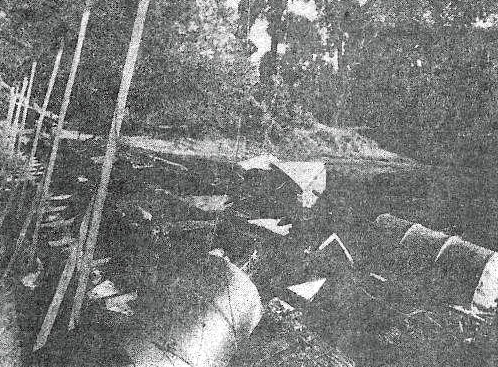
The charred remains of Puff, June 21, 1971. Pioneer Press photo
Sad to say, Bill Svensson died in Maple Plain, Minnesota, on November 17, 1998, and is interred at Lakewood Cemetery. He left behind three children – and the memory a summer of music and fun with a dragon named Puff.
This page covers the South/Purple Barn.
It was located at Highway 494 and County Road 18 (as first advertised), which now would be approximately West 78th Street, three blocks west of Highway 494 and Highway 169, in Eden Prairie.
There was another music venue called the Barn, active from 1957 to at least 1960. This one was located at the intersection of present-day Highway 169 and Rockford Road in Plymouth. This venue is discussed on a separate page.
THE SOUTH/PURPLE BARN
The venue in Eden Prairie was variously known as the Barn, the South Barn, and the Purple Barn
An article dated November 14, 1970, said that the club had been open four years, taking it back to late 1966. An item in a December 1968 Insider said that Bill Roslansky formed Young America, Inc. and purchased the South Barn with fellow shareholders Stuart Swartz and Stan Taube.
It was kind of in the middle of nowhere – Mike remembers:
The Barn would get invaded by hundreds of salamanders crawling on the floors after thunderstorms they would migrate there from the nearby swamp.
The photo below shows that the venue was clearly called the South Barn. Was there a North Barn?
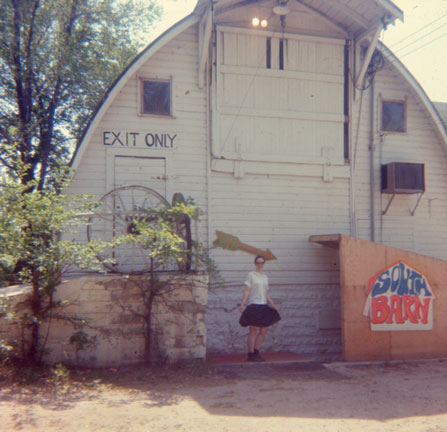
Photo courtesy Susan Shallman Anderson
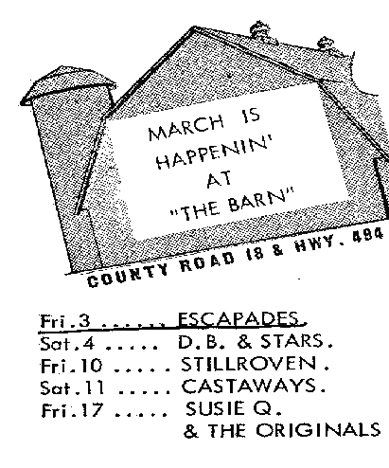
Barn Calendar, March 1967
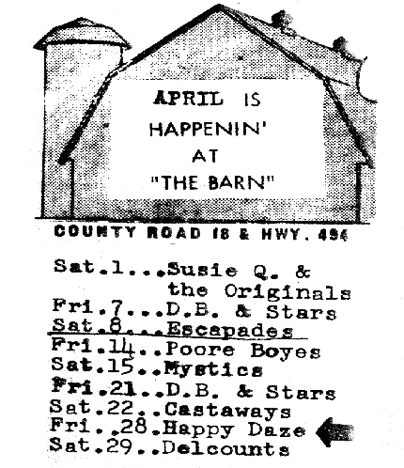
Barn Calendar April 1967
Neal Bond:
My recollections of the Barn go back to working as a band boy for the Stillroven way back when. I was in High School with Phil Berdahl and Danny Kane. They were playing there on a school night with the Underbeats. There was a very popular television show called The Fugitive which was having its television finale that night [August 29, 1967] and the drummer from the Underbeats was giving a blow by blow description of what was going on in that finale between songs. “Richard Kimball has found and is chasing the one armed man who murdered his wife” It was hilarious.
Bruce Glewwe remembers: “That whole area was probably farm land then. Went there only once…pretty freaky for a couple 16 year old guys from South St. Paul. The ‘black lights’ inside scared us off and we didn’t go in. We probably didn’t have the dollar or two it would have cost to enter either.”
BATTLE OF THE BANDS ’69
The Caretakers won the Battle of the Bands in 1969, sponsored by Len’s Guitar City. The sax player on the left is Richard Wieser – Tom Riopelle says Wieser played with Fairchild for many years to come. Lauren McArthur was on tenor sax, Bob Burtis on soprano sax, Steve Kenet on bass, Dave Weiking on drums, Mark Orlusky on lead guitar, and Dick Hiebler on keyboards. Bob Burtis says, “We did a killer version of ‘Heat Wave!'” Bob remembers, “We won a nifty reel to reel tape recorder and a little trophy!”
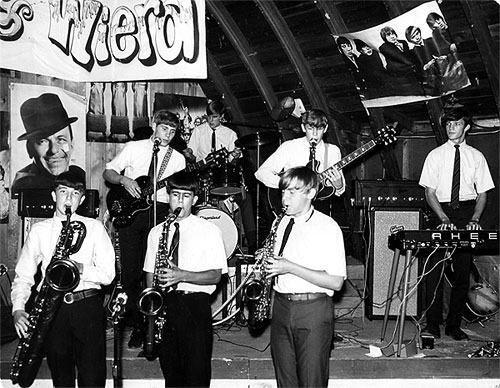
Photo of the Caretakers courtesy Bob Burtis
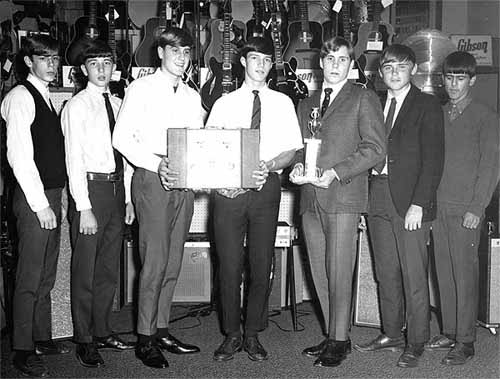
Caretakers at Len’s Guitar Shop, Courtesy Bob Burtis
Another contestant at the Battle of the Bands was Flight ’69. Not affiliated with the band Flight that became Pepper Fog.
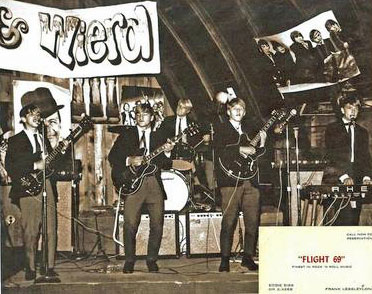
Photo courtesy band member Harry (Eddie) Eiss.
On August 8, 1969, Insider photographer Mike Barich made a trip to the Barn:
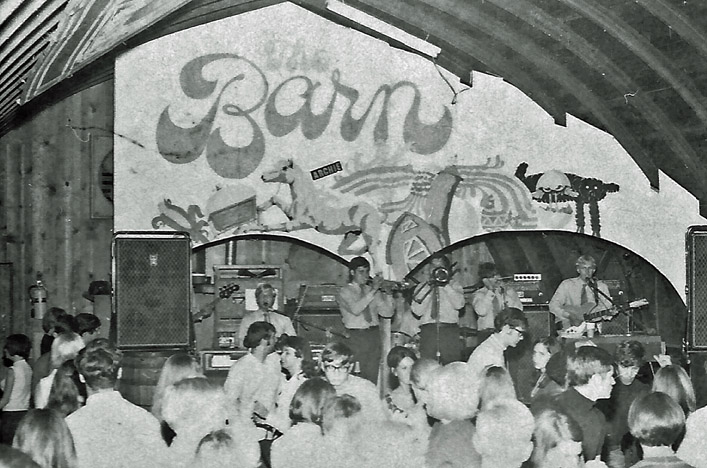
August 9, 1969. Photo copyright Mike Barich, St. Paul
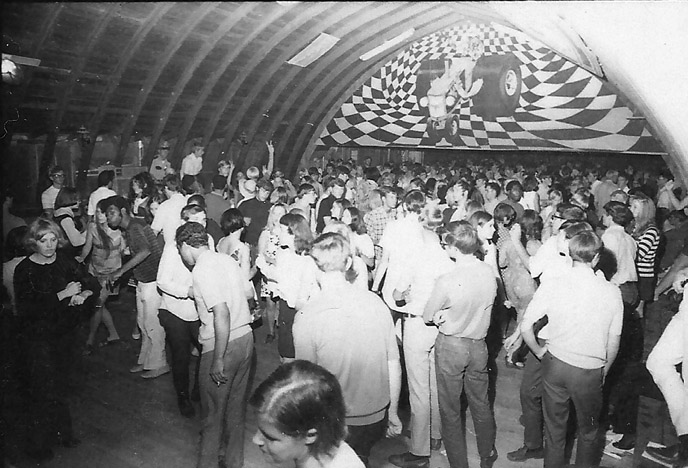
August 9, 1969. Copyright Mike Barich, St. Paul
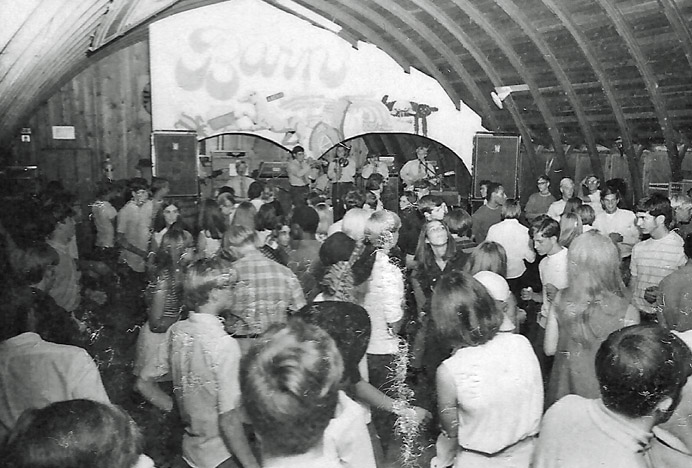
August 9, 1969. Photo copyright Mike Barich, St. Paul
There was no liquor served at the Barn, but teens seemed to get in trouble anyway…
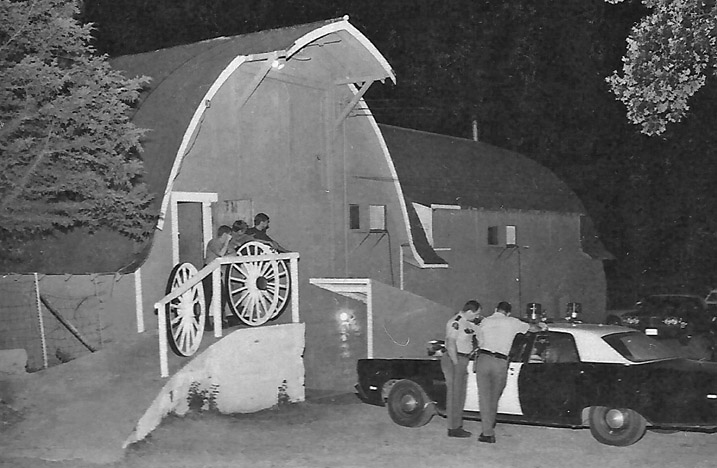
August 9, 1969. Photo copyright Mike Barich, St. Paul
THE PURPLE BARN
In 1970, the Barn was renamed the Purple Barn (Phil Kitchen says to sound more psychedelic), and in June 1970 the Friday night dances were dropped, leaving only Saturday nights. An article in the Minneapolis Star noted that dancing was waning and “listening is in.” (Peter Vaughan, November 14, 1970)
The posters below, from January and February 1971, indicate that the club was back to being open on Fridays and Saturdays.
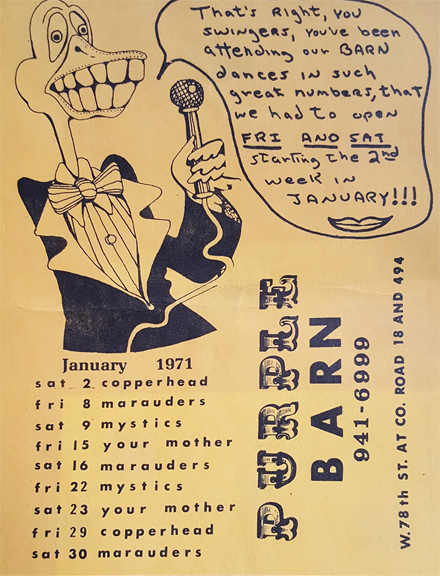
January 1971 poster courtesy Jan Marie Foster
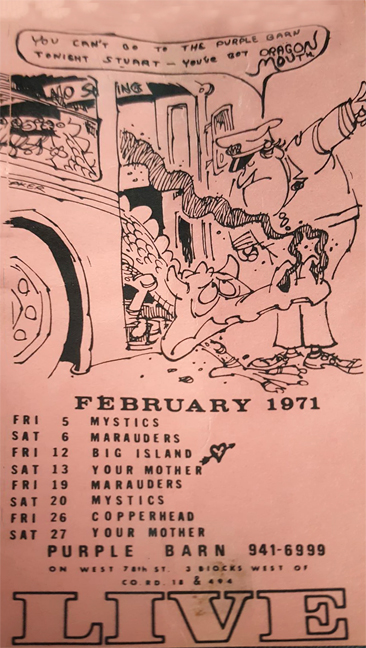
February 1971 poster courtesy Jan Marie Foster
Eventually the teen clientele dropped, partly replaced by school dances, and hit hard by the lowering of the drinking age in 1973. By 1973 it was the only teen rock club left, open only on Fridays. The last hit in the paper is in January-February 1973, where the Purple Barn was the site of an Antiques Flea Market.
The Purple Goblet was located at 118 W. Lake Street.
The owner was Lynn Thompson.
An article in Select Magazine from February 1961 said that the Purple Goblet had “salon music” one night a week, and otherwise featured a jukebox and men playing chess. They described a grey walled white latticed back bar with a French barmaid.
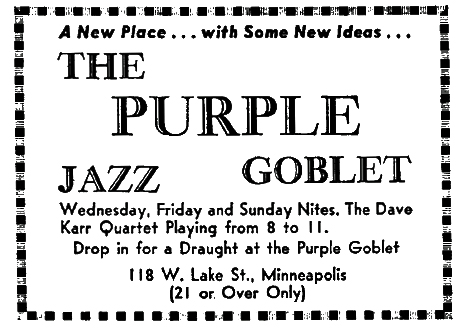
Minnesota Daily, June 1968
The Purple Goblet went out of the jazz business for financial reasons.
There were four different Purple Onions that I’ve found so far. The name is no doubt inspired by the folk club by the same name in San Francisco.
HAMLINE
Perhaps the most famous Purple Onion was located at 722 No. Snelling Ave. at the corner of Minnehaha Ave. in St. Paul, near Hamline University.
This location was first the Hamline Sweet Shop, going as far back to at least 1942. In March 1944, owner Alex Rosenberg forfeited $25 bail for violating food and dairy laws, and that November he was fined $50 for allowing minors to play pinball machines in his premises.
The Purple Onion is remembered as a place that allowed Bob Dylan to perform when he was kicked out of the Scholar and then the Bastille. The Purple Onion reportedly paid him $6/night for his nascent song stylings before he left town at the end of 1960. (Minneapolis Tribune, March 27, 1966)
An item from 1961 refers to the place as the Inn of the Purple Onion, William Danielson, Proprietor. The item calls it a tavern.
There is another reference calling it a pizza parlor.
The site became the Hamline Apartments.
MACALESTER
Steve Grooms remembered the Purple Onion as a “tiny basement coffeehouse on the Macalester Campus.”
BLOOMINGTON
The Criterion Restaurant, 5001 W. 80th Street in Bloomington, was briefly called the Purple Onion starting in about August of 1991, but went bankrupt two months later, if I’m reading this right.
DINKYTOWN
Pat Weinberg opened another Purple Onion in Dinkytown at 326 – 14th Ave. SE in about September 1993. In 2006 it was moved to 1301 University Ave. SE., in the first floor of an apartment building.
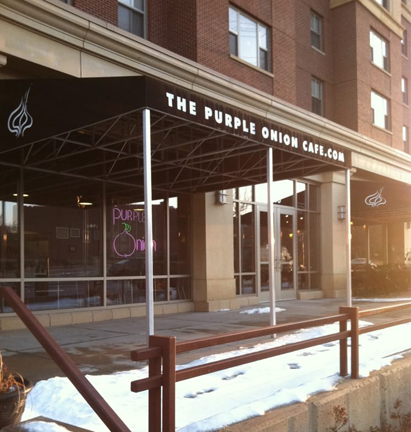
2017 From Company Website
The Radisson Hotel was located at 35 So. 7th Street in Minneapolis.
The “Minneapolis Hotel Building,” as the building was called on the initial blueprints, was primarily financed by a woman named Edna Dickerson, who ran a school for court reporters in Chicago. She inherited a considerable amount of money and property in downtown Minneapolis from a distant relative, Albert Johnson. While in Minneapolis to collect her inheritance, Dickerson met George Dayton and other prominent Minneapolis business people, who convinced her to invest invest some of her inheritance in the construction of a grand hotel next to Dayton’s store. Dickerson contributed $1.5 million to the construction of what became the Radisson Hotel.
The name “Radisson” was suggested by N.H. Owen, a member of the Commercial Club. Pierre Esprit Radisson, had crisscrossed the Great Lakes area in the 17th Century. It was believed, at that time, that Radisson had been the first white man to explore Minnesota. His name was not widely known because his travels into the area took place before settlements had been established and much local history had been recorded. Owen believed that naming the hotel after “Minnesota’s forgotten explorer” would give Radisson some much deserved recognition.
Construction of the Radisson Hotel began in mid-1908. The architects were Long, Lamoreaux, and Long, and the general contractor was C. E Haglin, both Minneapolis firms. The consulting engineer was Charles L. Pillsbury. The hotel would be the tallest building in America built with reinforced concrete. Construction publications also heralded the first use of steel sheet pilings that gave the hotel extraordinary strength at its foundation. The Radisson was one of the first structures in the United States to use this new type of construction.
The 16-story hotel was originally scheduled to have 325 rooms. During construction, however, the room count was increased by 100 rooms, for a total of 425.
Interior design was by William Frederick Behrens of New York City, who chose French Renaissance for the decor as a tribute to the hotel’s namesake, Pierre Radisson. The first managing director was Charles J. Owen, a former assistant manager at the Astor and Knickerbocker Hotels in New York City.
Although the owners (Edna Dickerson, now married to Simon Kruse) had hoped to have the hotel open for the 1909 Minnesota State Fair, construction delays caused the opening to be moved to December 15, 1909. When it opened it was the second-tallest building in Minneapolis, next to City Hall.
Room rates at the Radisson in 1909 started at $1.50 for a room without a bathroom. For between $2.50 and $5 a guest could enjoy the hotel’s finest amenities, which included a bath. Accommodations for two cost an extra dollar.
Entering the hotel, guests were shaded by a canopy 50 feet long, with glass and ornamental iron that extended over three doorways separated by columns of marble and framed in monumental bronze. Once inside, they would find a ladies’ sitting room (the Adams Room) located just off the lobby; a billiard parlor and eight-chair barbershop were in the basement. A lobby cigar shop offered the finest cigars, confections, and sodas of the period. Humidors capable of storing a million cigars were installed in the shop. Maurice L. Rothschild operated a clothing store on the premises. Also off the lobby was the hotel’s own library.
THE RADISSON MARCH
The Radisson’s grand opening on December 15, 1909, was highlighted by a gala dinner for a thousand guests. All the banquet rooms were pressed into service for the elegant dinner, which cost $5 per person. The Radisson Orchestra thrilled the guests by playing “The Radisson March,” written by Franz Dicks and published in sheet-music form by Joseph E. Frank. It was dedicated to the hotel and managing director Charles Owen.
OWNERSHIP
- Simon and Edna (Dickerson) Kruse owned the hotel until Kruse lost it in 1934.
- The Philadelphia Fidelity Trust Company owned it during the Depression years of 1934 to 1941.
- Tom Moore was the owner from 1941 to 1960.
- Curt Carlson purchased 51 percent of the hotel in 1960, and the rest in 1962. Carlson owned it until it was redeveloped.
ROOMS AND MUSIC VENUES IN THE HOTEL
The Chateau Room, the original main dining room, was located off the main lobby. Seating about 250 guests, this elegant establishment featured decorations and furniture patterned after the dining rooms of the Chateau Blois of the Francois-premiere period.
Every evening diners in the Chateau Room were entertained by a quintet from the Minneapolis Symphony Orchestra.
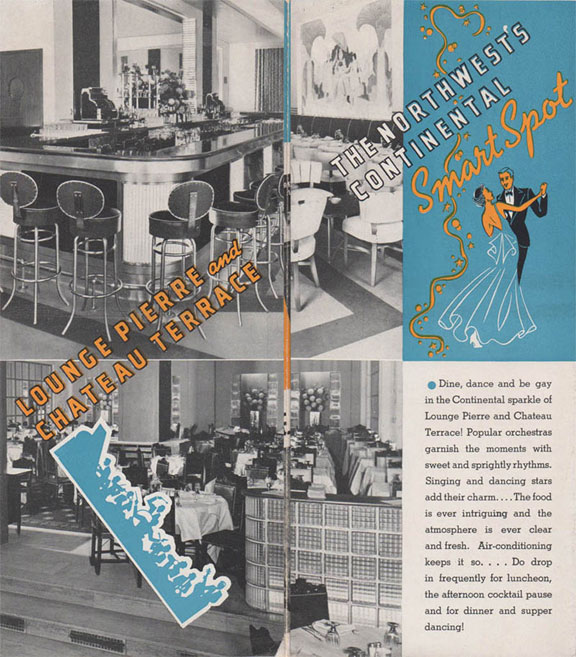
The Viking Room/Cafe, originally located in the rear of the hotel, seated 100 diners. This room was finished in dark stained oak and featured a silver scale-model Viking ship created for the hotel by Edward Caldwell. (The ship later hung in the Radisson Lounge called the Viking Room.) The Cafe’s walls were graced by ten murals painted by renowned Scandinavian artist Arthur Wilberg. The murals depicted scenes from Sweden and Norway.
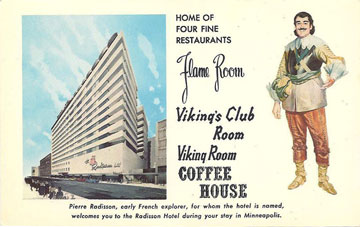
The Teco Inn opened in the hotel a few years after the hotel opened. The Teco Inn was one of the largest rathskeller-type dining rooms in the nation. It was furnished in richly-colored tiles depicting landscape scenes from around Minnesota and historic events bearing on the position of Minneapolis as the gateway to the great Northwest. An ad from the March 6, 1921, Minneapolis Morning Tribune promised a dinner dance every evening except Sundays.
The New Assembly Room “is recognized as the most popular and the largest cafe’s dancing space in the Northwest. The present attraction, ‘The Snappy Reubens Jazz Orchestra’ is THE Orchestra of the Season. Scheduled for March 15th next, the Famous ‘Silas Marimba Band.'” (March 6, 1921, Minneapolis Morning Tribune)
The Allee Pigalle was advertised in 1970 as the most intimate rendezvous in town. “Slip up the stairs and sip in seclusion on the balcony, or stay on the main and join bassos and sopranos at the Allee piano.”
Also in 1970 was the Lodge, complete with bearskins on the walls and an all-Minnesota menu. “Stay to dream over the music that starts at 9 pm; philosophize as the firelight casts a glow over the copper-topped bar, and the deer-head smiles down on you!” Piano by Delores Del Rae.
The Haberdashery
Capper and Capper, Ltd. was the first of perhaps several haberdasheries that occupied a prime location off the 7th Street lobby. Hubert W. White and Nicolas was the company just before the peanut bar opened in about March 1970. The Haberdashery (45 South 7th Street), like the Radisson Hotel, was owned by Curt Carlson. It was strictly a bar and the only reference to music found was a jukebox in 1980.
A second Haberdashery was opened in October 1973 at 1501 Washington Ave. in Cedar-Riverside in the Peterson Drugstore building. This location closed at the end of March 1983.
A third opened in the Radisson Hotel at 6th and Wabasha in St. Paul in September 1974. This one had a music venue, at least in 1977.
THE FLAME ROOM
The music venue that the Downtown Minneapolis Radisson Hotel is most famous for is, of course, the Flame Room. This restaurant was an institution in the Twin Cities and so many of us, our parents, and grandparents went there on special occasions for the special menu, celebrity performers, and the Golden Strings.
Flame Room I: 1925 – 1943
The first of its three Flame Room restaurants opened in 1925, originally on the mezzanine level. The Radisson also offered the so-called Radisson Roof for dancing during the summer months.
Early entertainment was provided by such bands as George Ganz and his Golden Gate Orchestra, Slatz Randall, and Craig Buie. From 1931 to 1937, Norvy Mulligan’s Orchestra played in the Flame Room and broadcast over KSTP in a program called “Dancing in the Twin Cities.”
Flame Room II: 1943 – 1957
In 1943 a new Flame Room restaurant opened. This one was just off the lobby, with an added entrance on Seventh Street. Patterned after a smart, small New York City nightclub, the new Flame Room drew the finest entertainers in the world and would eventually become as well-known as the Radisson Hotel itself. The Flame Room featured background music for its shows and dancing by Don McGrane and his Radisson Hotel Flame Room Orchestra. In addition, the finest acts in America were booked and the public responded by jamming the room nearly every night for both the early dinner and the late-night shows. Specially trained waiters served appreciative guests amidst dazzling arrays of flaming entrees. Among the most memorable Flame Room entertainers were Hildegarde and the late Carl Brisson, who played the Flame Room more often than any of the room’s other fabled stars. Comedian George Gobel got his start at the Flame Room. Other popular performers who thrilled crowds there included Peggy Lee (with Sev Olsen and His Band), Rowan and Martin, Tito Guizar, Nick Lucas, and Victor Borge. The dancing DeMarcos, Dorothy Shay, Joe F. Brown, Imogene Coca, Sid Caesar, Milton Berle, Burl Ives, Connie Haines, Abe Burrows, Liberace, and Phyllis Diller also made frequent Flame Room appearances.
In October 1952 the Flame offered $2,000 in “wonderful prizes” by naming the Flame’s “Mystery Husband.” Clues were given over Sev Widman’s WTCN radio show “Where’s Your Husband?” The same ad featured the DeMarcos, “America’s foremost dance team,” Don McGrane and His Orchestra, the Singing Embers, and Harry Blons’ Dixieland Orchestra.
Flame Room III
From 1957 to 1961 the hotel underwent a $7-million refurbishing program that would add 140 rooms and a brand-new and larger Flame Room. New owner Curt Carlson and the late impresario Al Sheehan (“The Aqua Follies Man”) brought the Golden Strings to the Flame Room in 1963. Carlson had seen a dazzling violin show in Mexico City in 1962. He asked Sheehan to put a similar act together, and the new ensemble, named the Golden Strings, opened in the Flame Room on February 16, 1963. The group – made up of eight violins, a bass violist, and two baby grand pianos – played the room until 1981, when the hotel closed. Performing before more than two-million people over more than 18 years. the Golden Strings was, according to Variety magazine, the longest running violin show in the world. (Carlson also put the first real “flame” in the room when he installed two giant, gold-plated, gas-powered torches that created brilliant colored flames during the Golden Strings shows.)
A 1960s promotional brochure called it the “only dinner show of its kind in 50 states,” although a July 1963 ad in the Twin Citian said that similar groups existed in Japan, Paris, Mexico City, New York, and Las Vegas. The ensemble played three shows nightly (except Sundays) with dancing after 10:30 pm with the Flame Room Orchestra. Just before the act opened Will Jones described the scene:
All kinds of special lights and equipment have been installed for the new show. Each violinist has his own spotlight and besides memorizing two different shows of 21 or 22 tunes each he has to know how and when to be planted under his spotlight, smiling. There are other spotlights for big sprays of roses hung on the walls, and there are candelabra that brighten and dim on cue. And come opening night, with luck, there are going to be long jets of flame leaping up on either side of the bandstand at dramatic moments… And what will the Golden Violins play? … Gypsy music, Irish music, Scandinavian music, any romantic tunes you’d expect to hear .. in an all-red, candlelit dining room, you’ll probably hear them all. .. Take your best girl and don’t let her get her wig near the flamethrowers.
DEMOLITON
The grand downtown Minneapolis Radisson Hotel closed on November 20, 1981. The structure was razed by implosion in about nine seconds on December 6, 1982.
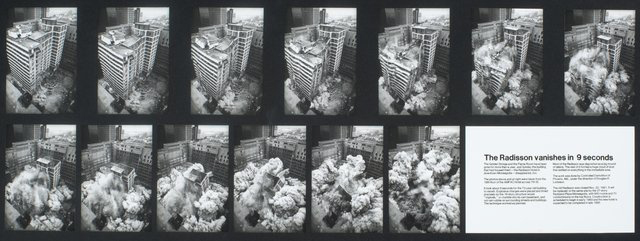
Minneapolis Star and Tribune, December 6, 1982
A 360-room Radisson hotel was built in 1986 with the help of a Federal loan from HUD at 35 South 7th Street.
The new Radisson Plaza Hotel building was remodeled and rebranded as the Radisson Blu in 2014.
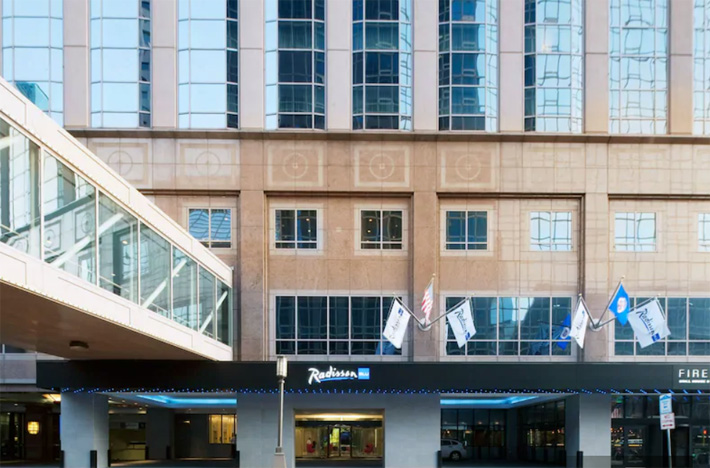
Radisson Blu
In 2021, it was rebranded again as the Royal Sonesta, a new chain.
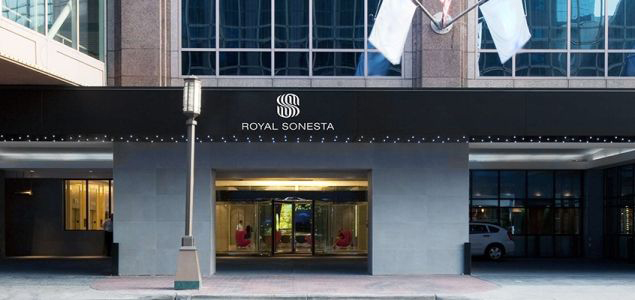
Royal Sonesta
RADISSON INN
During the 1920s the management of the Radisson Hotel downtown received requests from guests for recommendations as to where to stay on Lake Minnetonka. Thinking he might be losing some business and to further accommodate Radisson guests, hotel owner Simon Kruse purchased the 53-acre Glen Morris Inn on Christmas Lake near Excelsior, Minnesota, minutes away from Minnetonka. Kruse changed the name to the Radisson Inn and turned over its management to his wife’s cousin, Belle Beazell. Open only during the summer, the inn was a popular picnic spot for families and companies. It was not uncommon to see ladies in their long dresses playing croquet on the inn’s spacious lawn. The inn also featured an enormous, 240-foot-long front porch; many of its 40 rooms offered sleeping porches. The inn was renowned for its excellent food, particularly its Sunday-afternoon chicken dinners. In addition, the facility offered boating, sailing, tennis, fishing, and horseback riding. But no liquor was served while Radisson owned it. Besides the rooms in the main building, there were a number of cottages on the property, many of which still stand today on the north end of Christmas Lake. The road that runs past the inn and the cottages was christened “Radisson Road,” the name it bears to this day.
The Radisson Inn presented Supper Dances with Frank Gordon and his 11-piece Orchestra, featuring Gertrude Carpenter, in October 1934. Dinner was 6 to 8 pm, and
supper was 9:30 to closing. So that’s the difference! As reported in the Minnetonka Record.
Due to financial setbacks, the Kruses traded the Inn for the Windsor apartment building at Franklin and Third Ave. So. The inn was taken over by Lou Cohen of Roycraft Corporation, who ran it as a nightclub until it burned to the ground in 1936. The club “featured dance music during the 1930s by Norvy Mulligan, and the group played as much jazz there as the management would allow.” (Stebbins)
For a more detailed history of the Radisson Hotel and Inn, click Here.
The Radisson South Hotel was built at the northwest corner of Highways 100 and 494. The address is 7800 Normandale Blvd.
Curt Carlson’s flagship hotel had 565 rooms in 22 stories. It cost $14 million to build. The first event was “Enchanted Evening,” a benefit show starring Carol Channing and Shelly Berman on September 26, 1970. 1,200 people paid $50 each, to benefit two Minneapolis Boys Clubs.
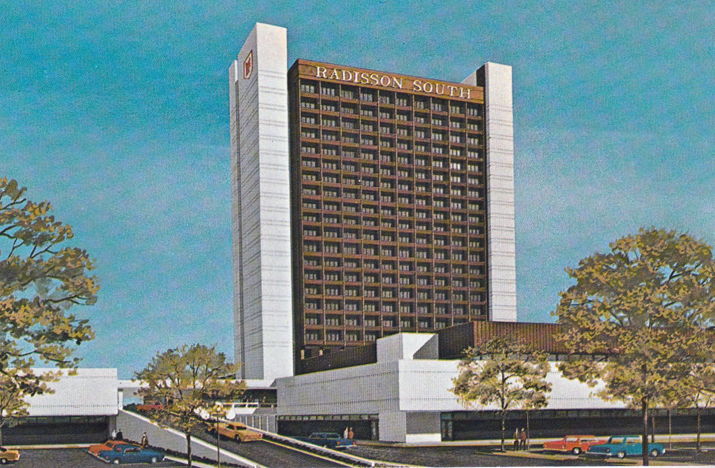
Undated postcard – not exactly accurate
In 1974 there were three venues:
- Mr. C’s
- The Tiffany Restaurant
- The Shipside Restaurant
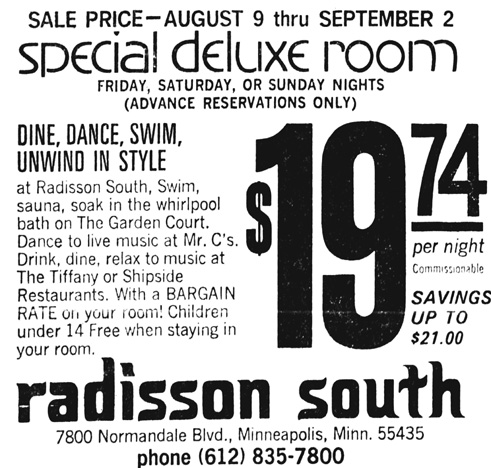
August 4, 1974
In the late 1970s, the hotel acquired an adjoining parcel of land to expand capacity. The hotel was in Bloomington, but the new addition would be in Edina — where no liquor could be sold. A solution was reached when the cities agreed to a land swap, putting the Radisson addition in Bloomington.
In 2004 it became a Sheraton Hotel, and then a Doubletree.
The Rail Inn Tavern was located at 2747 Central Ave. NE in Minneapolis.
This building was built in 1922 as an 18 x 22 frame shop. It was listed as a cafe and then a tavern in 1935.
The first hit on the Star Tribune archive was on May 23, 1949, when “Yeggs” (an old school term for burglars) broke in, stole their safe, and carted it away in a kid’s stolen coaster wagon. Police were looking for Yeggs with big muscles. The proprietor was named as Gordon Hewitt.
Hewitt himself was accosted in August 1949, but all the robbers got was $5 out of this wallet.
Thieves broke in again in November 1956, but all they got was $25.
Sherwin Linton posted this fabulous picture of himself here in 1958. He says, “Those boots were turquoise with black flame trim!”
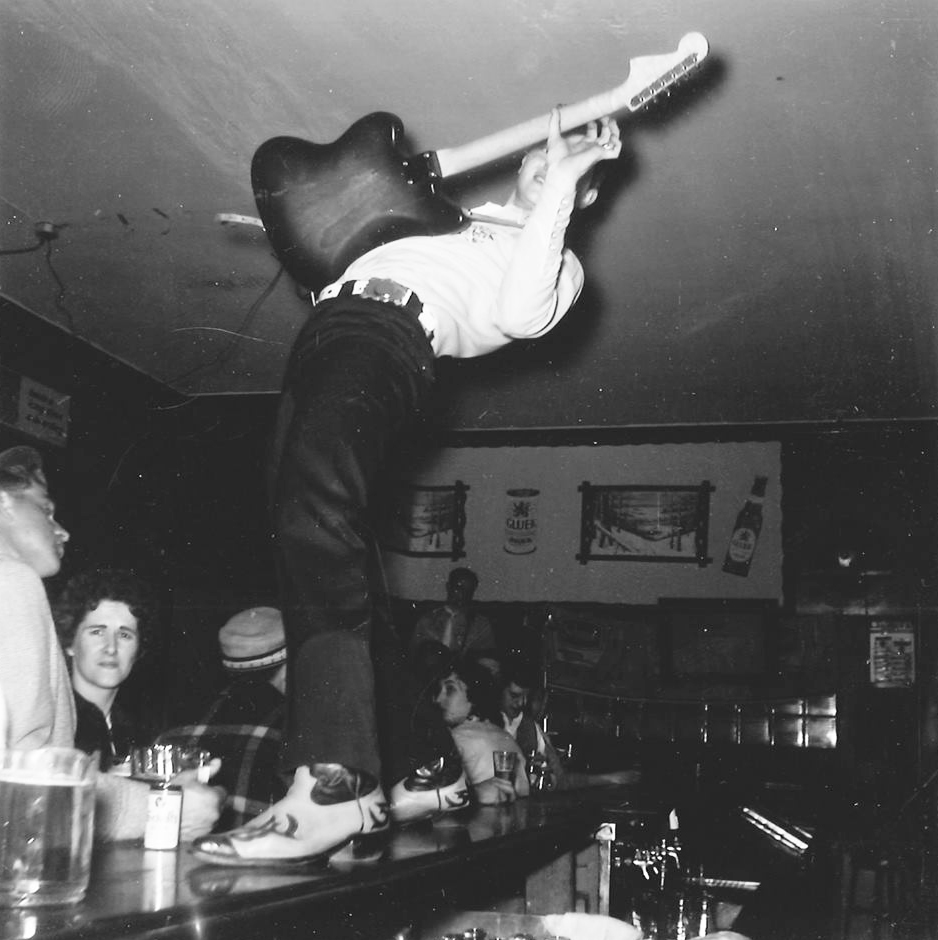
Photo courtesy Sherwin Linton
On January 5, 1959, the bar belonged to Don Bumgardner, who was planning to take the night off to go bowling. As he was shaving in the back room, two customers became robbers, and got away with a considerable amount of money, most of it the personal property of Bumgarnder. The stickup men turned out to be brothers Don and Richard Foley, who were on a crime spree, but were caught on January 5 after another robbery when their car wouldn’t start.
All licenses belonged to Mrs. Irene Hanson, including the 3.2. onsale beer license, which was revoked on September 26, 1962, when Mrs. Hanson pleaded guilty to selling beer to a minor. She had been fined $75, and broke into tears when told that revocation of her license was automatic in this instance. (Minneapolis Tribune, September 27, 1962)
The Rail Inn appears in the Minneapolis Tribune archives on October 2, 1965, when a bartender was jailed for “alleged illegal sale of beer.” A ten-day suspension of the license was also recommended.
The Rail Inn was in trouble in 1969 when a waitress pleaded guilty to serving whiskey on March 30. The last notice in the paper was “City May Suspend License,” on May 22, 1969. Apparently the bar went out of business after that.
The property is now the parking lot of the Minneapolis Central Corps Salvation Army.
Rainbow was a popular name! Here’s a matchbook from Mark Youngblood’s collection – just in case.
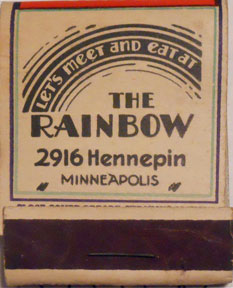
There was also a Rainbow Inn on Wayzata Blvd. in October 1937, Frank Jackson, Proprietor. Other than that, I know nothing!
The Rainbow Bowl was located at 1928 North Second Street in Minneapolis. The property is also known as 125 West Broadway.
In 1892, a 22′ by 44′ two-story wooden duplex was built on this large corner lot at a cost of $1,200.
BEER PARLOR
One of the units was being used as a soft drink restaurant in 1932, but that June, proprietors August W. Blake and James O. Richardson were arrested by Federal Prohibition agents who found moonshine and alcohol behind the bar. Richardson had been arrested twice before. (Minneapolis Star, June 11, 1932)
In November 1933, it was James Setters’ Beer Parlor. Beer had been legal since April 1933.
It appears that a second duplex with the same dimensions was built on the same lot in 1951 at a cost of $800.
In January 1961, both duplexes were demolished.
BRIDGEWAY BOWL
The Bridgeway Bowl opened in November 1961, and featured the Gold Room for dining, and the Dolphin Room with Bev Warren at the Piano Bar.
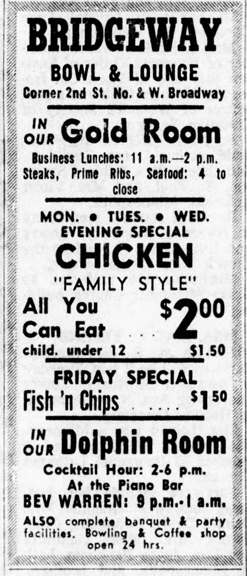
Minneapolis Star, February 26, 1962
The ad below promises a complete night of entertainment, including the Piano Lounge.
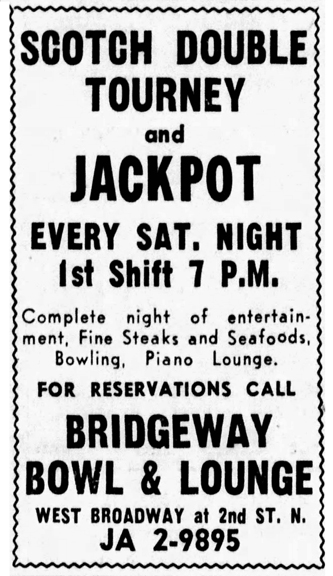
Minneapolis Star, October 2, 1964
A November 5, 1964 ad for the Bridgeway Bowl and Lounge invited us to “Bowl and Dine, Sing, Sip, Smile with Gene Lowrie in our Piano Bar.”
In 1966, John Iacarella and Stan Piersak had owned the building, but lost it through foreclosure, thus losing their liquor license. A license was transferred to John Myslicki from another location at 311 Main Street, which was taken for freeway construction. Myslicki had been a bartender for the Bridgeway Bowl. (Minneapolis Tribune, July 28, 1966)
RAINBOW BOWL
The Bridgeway Bowl reopened as the Rainbow Bowl in about July 1966, with Emil Sievert, Proprietor.
An ad in 1967 promised an upstairs lounge with entertainment, and a piano bar.
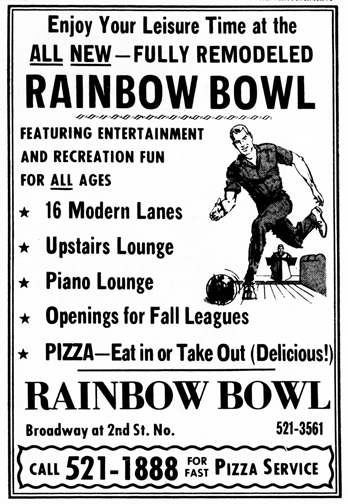
Minneapolis Tribune, August 6, 1967
By 1971 it was called the Rainbow Bowl and Lounge.
On February 16, 1972, a man drank beer and brandy for 11 hours at the 200 Club and the Rainbow Bowl, and then committed suicide by jumping off the Third Ave. bridge. His wife sued the bars under the dram shop law, and each was ordered to pay her $15,000 for continuing to serve an intoxicated patron.
The photos below were found online and are believed to have been taken at the Rainbow Bowl. The band’s name was Rainbow, and members included keyboard player Craig Horner,drummer Edgar Murphy and guitar player (not shown) Billy Franze. Thank you, Debbie Zitzloff Deans!
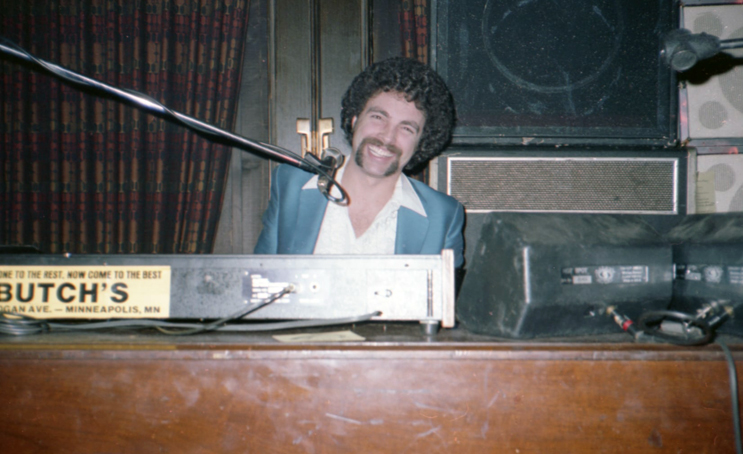
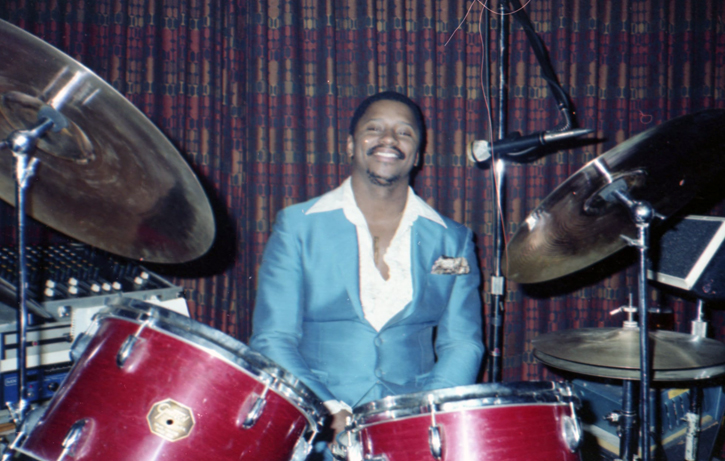
In April 1985 the complex was under new ownership.
MARV’S
Facebook chat says that it was purchased by a man named Marv, and that it closed in 2014.
In the 2011 obituary of Robert Leland it said that he and his wife Joan owned the Rainbow Bowl for 20 years.
As of 2020, the building still stands as an office complex.
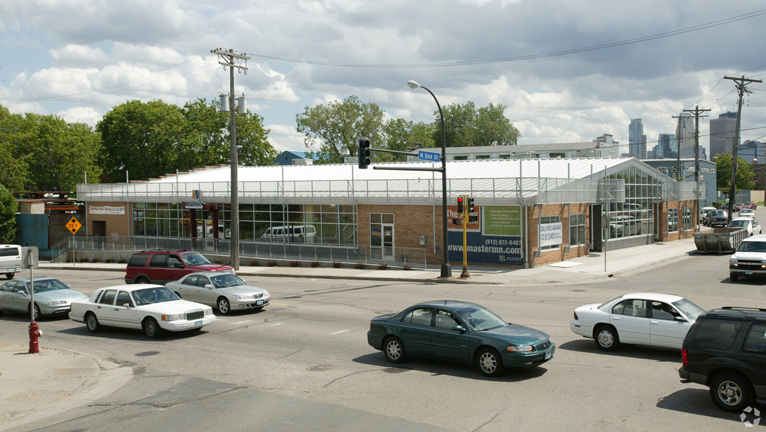
1500 S. 17th Ave., West Bank. Owned by Steve Kimmel; jazz, “modern and experimental sounds.” Site of after-hours gatherings. Light rail goes through it now.
North shore of McCarron’s Lake, St. Paul (out Rice Street). Site of dances sponsored by the Rainbow Social Club in 1936 -1937
The Rainbow Inn was originally Gleason’s Tavern, located on Highway 5 (Central Ave.) in New Brighton. The first glimpse in the papers is May 1, 1931.
There was at least initially a Rainbow Inn Orchestra, which was broadcast over WDGY radio.
After ten years, the Rainbow was in trouble when the U.S. government chose New Brighton for the site of a small arms ammunition ordnance plant, and the Inn was within the borders of the 2,400 acre tract. Every resident of the area was ordered to move, although one family with a newborn was given special dispensation. The Federal Government took possession of the land on August 4, 1941 at a cost of $30 million
The owners of the Rainbow Inn had tried to sell the April before this happened, revealing in their ad that it was at the intersection of State Highways 8 and 10, 1 1/2 miles north of New Brighton. The building included living quarters.
Interestingly, the Rainbow and another tavern, the Hillside, were converted into temporary headquarters for the construction – the Rainbow was the administration office, and the Hillside was the field auditing headquarters.
About 200 men came for jobs on the first day, but the facility was not ready for them. Construction began with about 60 men on August 16, 1941. Eventually it was expected that 9,200 people would be employed by the plant.
Personnel moved out of the Rainbow on September 23, 1941. From there the building was probably demolished.
666 Grand Ave. in St. Paul in 1957. That May the Dining Car Employee’s Union Local 516 held their Inaugural Ball there, with music by Percy Hughes.
This page covers various venues located a 1102 Hennepin Ave. in Downtown Minneapolis
- The Ramona Cafe
- Harry’s Tap Room
- Mousey’s
THE BUILDING
The Minneapolis Permit card shows that the first building on the site was a parsonage, built in 1884 for $9,000. Its dimensions were 48′ by 70′. It is unclear when this building was demolished, as there doesn’t seem to be a separate entry for its demolition before the next building was built.
In September 1909, a permit was obtained to build the Hennepin Hotel, which had seven stores and 50 rooms, at a cost of $40,000. It was three stories tall, with a footprint of 66′ by 141′. The hotel had a separate entrance at 3 North 11th Street. Over the years, first floor tenants included:
- Cafe: 1911
- Auto sales room: 1919
- Gas station: 1920
- Barber shop: 1920
- Pool hall: 1923
- Bar: 1936
THE RAMONA CAFE
The Ramona Cafe was run by Abe Percansky and his wife Mildred (Millie). For more about Abe, see the Flame Cafe.
1926
Abe got a license for a pool table at 9 No. 11th Street in April 1926.
1929
According to a note in the Minneapolis Star on July 16, 1937, the Ramona had the record for dining and dancing to local bands without a break, which was eight years: that brought the club’s start to 1929. The dance hall license was in Millie’s name.
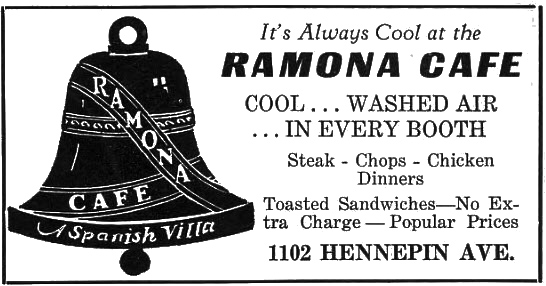
Ad from American Jewish World, May 27, 1932. Courtesy lyfmap.com
1931
Abe had a license to run the hotel from at least 1931 to 1933.
1933
Millie got a Tavern (3.2 beer) license for 1102 Hennepin on November 28, 1933.
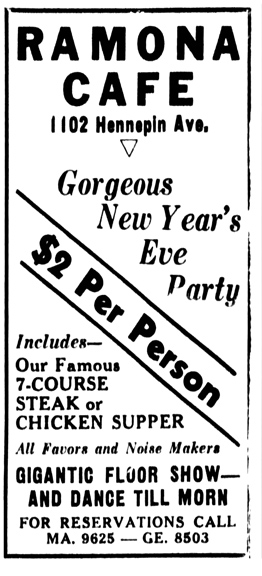
Minneapolis Star, December 30, 1933
1934
Apparently getting a liquor license for the Ramona wasn’t easy for the Percanskys. This article appeared in the Minneapolis Star on March 9, 1934:
During the committee session, a heated argument arose over the application of the Ramona cafe, 1002 Hennepin avenue, operated by M.A. Percansky. Capt. A. C. Jensen, head of the police license inspection division, produced records showing Percansky in 1923 was arrested on a charge of assault with a deadly weapon, and later on a disorderly conduct charge.
“I’d never give that dirty rat a license,” Alderman O.A. Pearson interjected. “He’s been up her all the time, and I object to his continual hollering before the council.”
Percansky admitted he had been arrested “once or twice,” but contended he had never been convicted and that for the last 11 years, he has “been all right, and am now running a legitimate business.”
But from the ad below we see that they prevailed, as long as it was in Millie’s name.
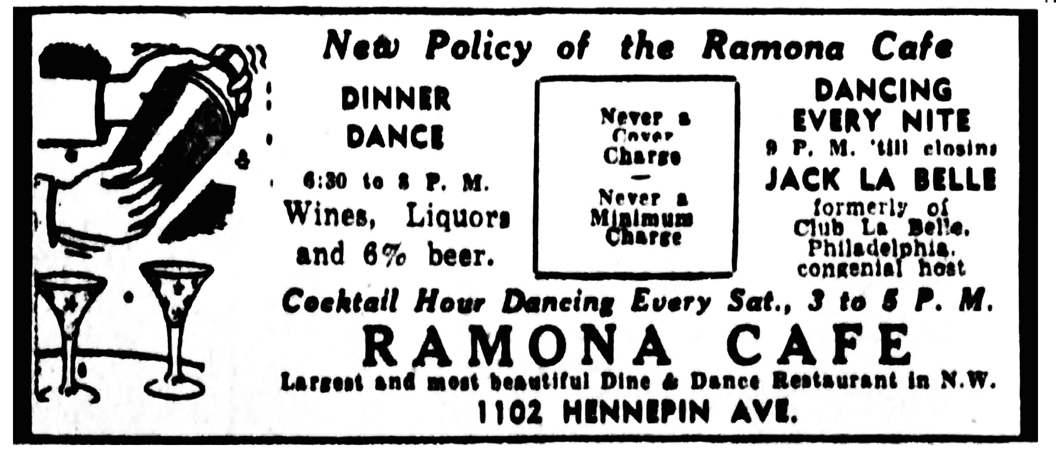
Minneapolis Tribune, April 7, 1934
1935
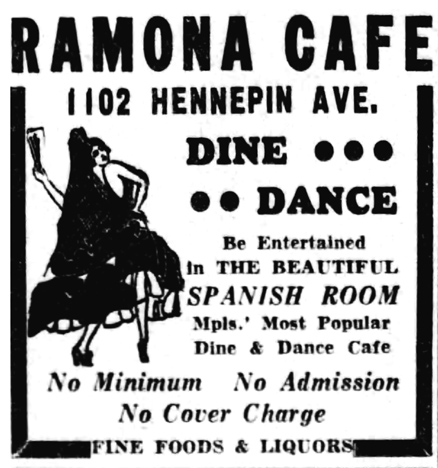
Minneapolis Star, April 18, 1935
In the ad below – do you ‘spose Congenial Host Micque Cohn pronounced his name Mickey?
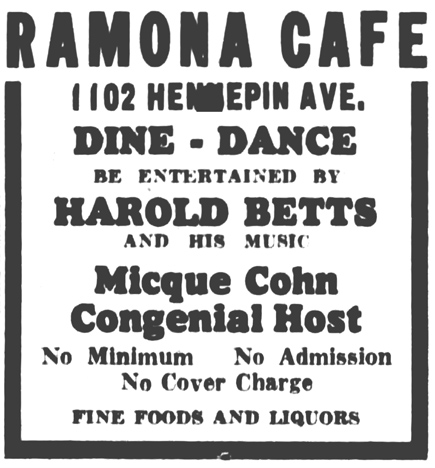
Minneapolis Star, May 16, 1935
In the 1930s, there was a column, ostensibly by Walter Winchell, the New York gossip columnist, that “Tells You Why to go Where!” How he knew about hot spots in Minneapolis was a mystery, but on November 8, 1935, he highlighted the Ramona Cafe, saying, in his own, special vernacular:
Eater-cuters know it’s fun to drop in at the Ramona Cafe – where there’s dancing very eve’g to Maurice Pischa and his musickers – grand food, f’rixample, the steaks and sea food – and no extra fee tacked on to your bill.
Matchbook below from the collection of Mark Youngblood.
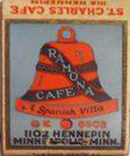
TROUBLE AT THE RAMONA
1937
In October 1937, Aileen Fletcher, 21, was fined $25 for operating a “Bing” game at the Ramona – a gambling game with dice. (Minneapolis Star, October 20, 1937)
1938
On August 29, 1938, there was a street brawl near the Ramona, now run by Dorothy Garfinkle. One young man was killed. Charges were filed against Garfinkle for serving beer to a minor, selling liquor without a license, selling liquor to minors, and running a “14” Game (Gambling). A jury found her guilty, and she was sentenced to a $100 fine or 60 days in the Workhouse.
In December 1938, the liquor license of the the Ramona was transferred to Abe’s new club, the Happy Hour.
1102 Hennepin became the home of Surplus Supply House through the 1940s.
Jerome Kelman was identified as the operator of a tavern at 1102 Hennepin from about May to July 1950.
HARRY’S TAVERN
In December 1951 there was a reference to Mrs. Helen Braman, who held a 3.2 license for Harry’s Tavern, in trouble for serving beer to minors. In January 1952, a painter was painting murals at Harry’s Tap Room, when a thief stole his coat, hat, etc.
In 1952 the beer license was transferred from Helen Braman to Alex Ostrowsky.
In May 1958 it was again (or still) Harry’s Tap Room.
MOUSEY’S BAR I
1102 Hennepin became Mousey’s Bar by August 1958, perhaps earlier. Mousey’s was not a music venue – one most likely heard Country music on the jukebox.
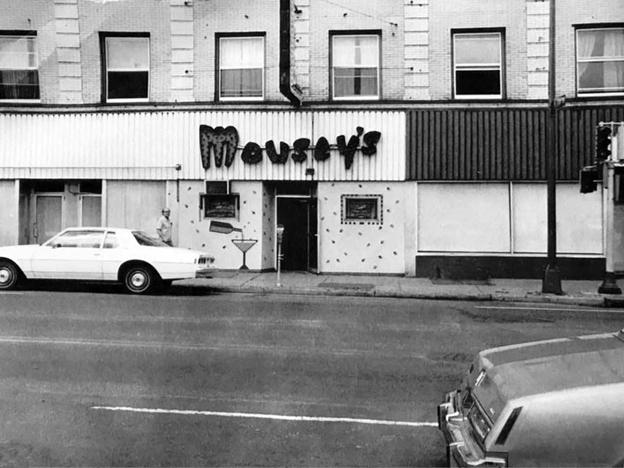
Photo courtesy Joe Myers
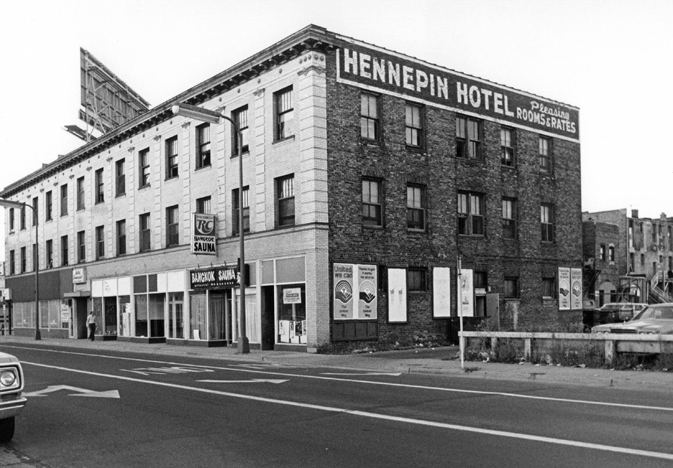
Hennepin Hotel, @1980. Photo courtesy Hennepin County Library, via James Orndorf
MOUSEY
Information about Mousey came from an interview with Holly Rae, his daughter, with thanks.
It turns out that Mousey was none other than Alex Ostrowsky, who had operated the place as Harry’s Tap Room since 1952. Alex’s father was a tailor for the Czar in Odessa; when he came to America he shoveled coal, and became a mob strong arm man, collecting debts. “Al,” as Holly called him, grew up in the Bronx. He was shot as a kid and thrown in the East River, fished out by a garbage scow. He ran numbers, and “could get out of anything.” His moniker came from the fact that he had big ears. He was recruited to play pro baseball, and could pitch a ball “through a mouse hole.”
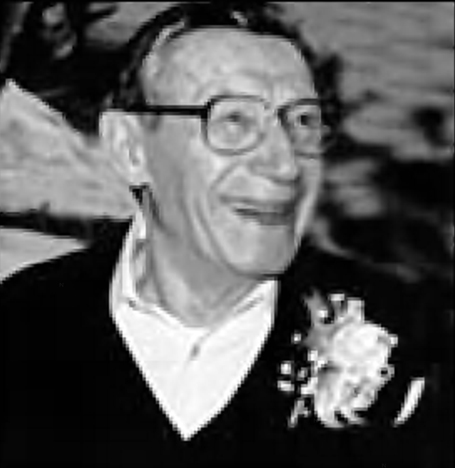
Mousie was a medic in the Army, and was one of the first to enter Auschwitz. He hated Germans. When he returned from the War he owned two or three bars on the Iron Range in his early 20s. He was a gambler, but never went to jail. He lost one of his bars on a flip of a coin. Before he had Harry’s he had managed Augie’s, and had been a bartender at the Lincoln Del. He was the handball champion at the YMCA, and often bailed people out of jail.
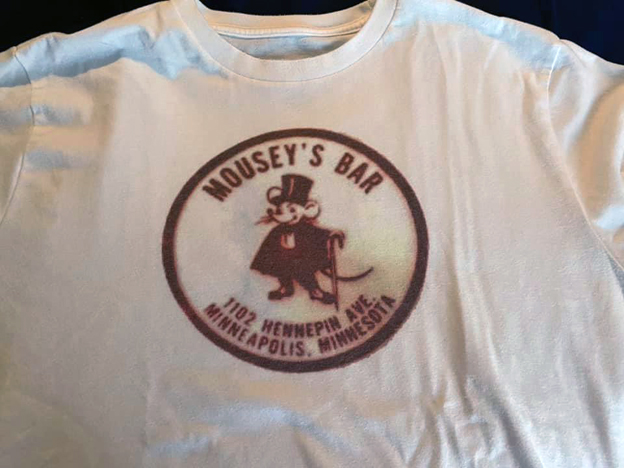
Photo posted on Facebook by Greg Kjos
Holly, who worked at the bar for five years in her 20s, called it the “worst, toughest bar in Minneapolis.” It was located amidst day labor businesses and adult bookstores, and the Hennepin Hotel was run down and full of prostitutes. Patrons were often fighting with each other, and she was often “terrified.” She spoke of riding her bike from the Knollwood area of St. Louis Park to the bar, and this was in a bike-unfriendly world.
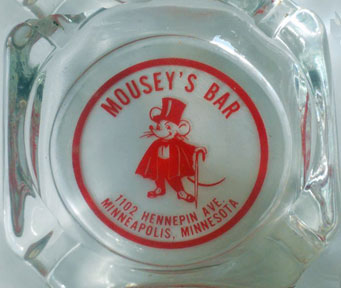
From the collection of Mark Youngblood
Facebook Facts:
Mouseys was often mentioned by Dave Moore on the Bedtime Newz!
“I use to joke with my friends that I could take my oldest, most worn out clothes, have a bus run over them a few times before I put them on, and still be the best dressed guy in the bar.”
In June 1960, the City received a request from George Bliss, who owned the Congress Bar in the doomed Skid Row, to transfer his liquor license to 1102 Hennepin, which was still a 3.2 tavern.

From the collection of Mark Youngblood
FIRE
On November 30, 1980, a four-alarm fire destroyed the Hennepin Hotel and Mousey’s with it. A janitor at Mousey’s was killed in the fire. Four others were taken to the hospital with injuries. The Red Cross assisted 60 people with food, clothing, and shelter at the Andrews Hotel. It was the third fire in the building in four months: two people were seriously injured in a fire on July 10, and another fire broke out on July 22 but no one was injured. (Minneapolis Tribune, December 1, 1980)
The fire left the building a charred shell, and a crane from Carl Bolander and Sons had to be brought in to empty it out in order to dump the smoldering insides onto the street and extinguish the remains. Holly Rae remembers standing out on the street for 24 hours, making sure to retrieve the safe among the ruins per her father’s instructions. Mousey himself had been in the hospital for prostate surgery for 28 days.
The fire was believed to have started in a kitchen ceiling at Mousey’s and could have been burning a while before a janitor discovered it. Two other businesses were destroyed: The Bangkok Sauna, and a Catholic Charities feeding center called The Branch 2, which had just opened in February 1980.
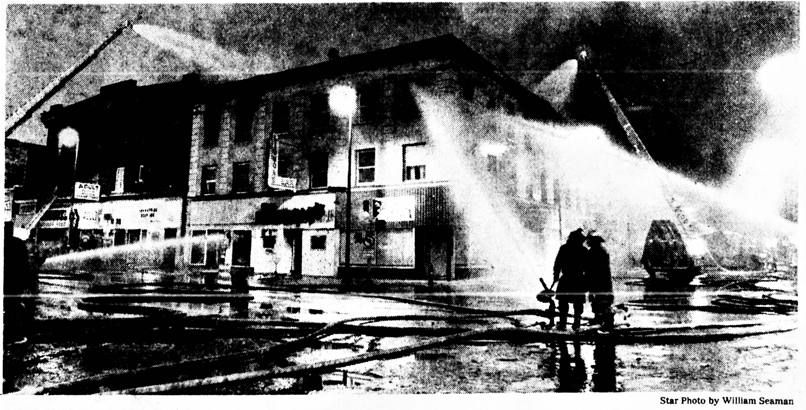
Minneapolis Star, December 1, 1980
On November 30, 2000, the Star Tribune reported that the fire at the Hennepin Hotel had always been suspected of being arson, and there was always a suspect in mind. The man had been connected to several other instances of arson, and had threatened to burn down Mousey’s after he was kicked out by a bartender. In addition, a gas station attendant remembers him buying gas an hour before the fire, the janitor who survived said he smelled gas coming from the apartment above the bar, and the now-Fire Chief was convinced that an accelerant must have been used to fuel such a fast-burning fire.
The hotel at 1102 Hennepin Ave. was demolished in January 1981. It was replaced by the Hennepin Crossings Apartment Complex.
MOUSEY’S TOO
Mousey gave up the bar and ran operated another one for several years. In 1984, he started up Mousey’s again at 1110 Hennepin Ave., which was formerly the Carousel Bar.
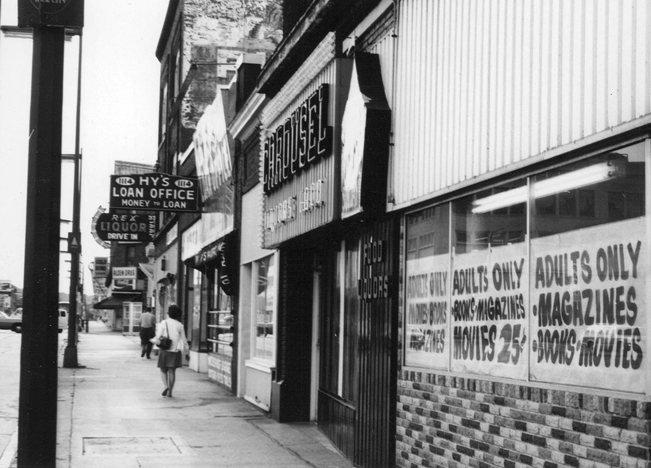
Carousel Bar. Photo courtesy Hennepin County Library, via James Orndorf
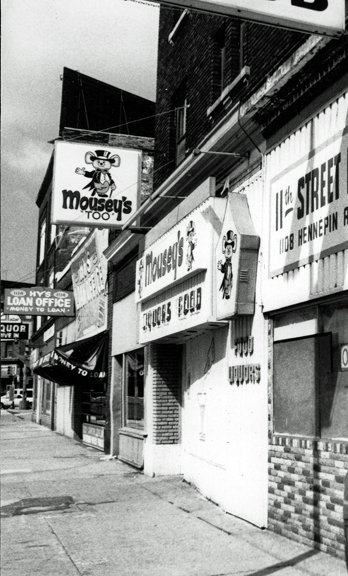
Photo courtesy Hennepin County Library, via James Orndorf
That building was scheduled to be demolished in August 1987, but things were so out of control that the City Council was trying to get the bar to shut down the June before. One police officer testified that Mousey’s had become a “festering sore.” Mousey claimed that he was being unfairly targeted, but the police countered with statistics:
- In 1986, police were called to the bar 285 times; drinking or violent behavior accounted for 177 of those calls.
- In the first five months of 1987, there were 180 calls to the bar.
Based on these statistics, Mousey’s was given a five day suspension starting July 1, 1987.
The bar soon closed for good, and the entire block was demolished for the Laurel Village Apartments development.
MOUSEY’S BAR III
In Jun 1989, Mousey applied for yet another liquor license, this time for a location at 1019 Currie Ave. N. The application was rejected 2-0 by the license committee, because of Mousey’s record, and because the location was close to the Salvation Army, Catholic Charities, and the Regency Hotel.
No more was said, so let’s assume that Mousey went into retirement.
Alex “Mousey” Ostrowsky died on April 28, 2011, at age 94, of complications of the flu. His obituary read,
An Urban Legend, and great man of Minneapolis was knocked down in the 94th round by flu complications in St. Louis Park.
Please see Bow and Arrow Club.
The Ranch House was located at 7958 Lyndale in Bloomington.
It was owned by Harriet Long of the Sleizer and her son Greg.
This building had previously been occupied by the VFW, which had moved to the building formerly occupied by the Air-O-Inn. The VFW’s address had been 7950 Lyndale in 1951 and the Ranch House had the address of 7956 Lyndale.
1969: The In-Four Group with Bev Hanson.
Celebrated its 21st Anniversary in 1973.
When you think of the name Danceland, you think of Big Reggie’s Danceland, the ballroom by Excelsior Amusement Park. But after that famous Danceland ceased to host musical entertainment at the end of 1967, the name was used for another venue entirely.
Randy’s Square Danceland was located 6 miles west of County Road 10 (not in Excelsior). Randy Dougherty was the owner and caller. It apparently operated from January 1968 to October 1970.
See The Office.
1019 Washington Ave S. In 1974 it was described in the Insider as a “Rock Disco.”
The Red Feather Nite Club was located at 665 University Ave. in St. Paul.
It was there as early as 1954, evidenced by the photo below which was posted on Facebook by the Eoin McKiernan Library. The photo was from an event in 1954 honoring Twin Cities Irish American Club members who had served in the US military, and was donated by former club member Patricia Mahoney Dee.
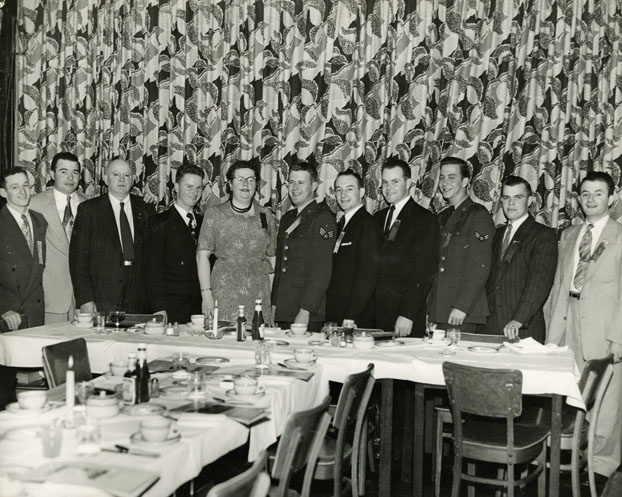
Pictured are: Joe Dowling, Martin Casey, Master of Ceremonies Paddy Hill, Pat Conroy, Club President Mary McGing, Denis Dee (Pat’s husband), Cornelius “Con” Sullivan (Pat’s cousin), Tom Malone, Stanley Jett (friend of Denis Dee’s visiting from Maryland), Martin McHugh, and Michael Sullivan (Con’s brother).
In February 1958 there was an item about an opening with C.V. Williams and his band.
The following two images of the Red Feather’s menu come from the Minnesota Historical Society:
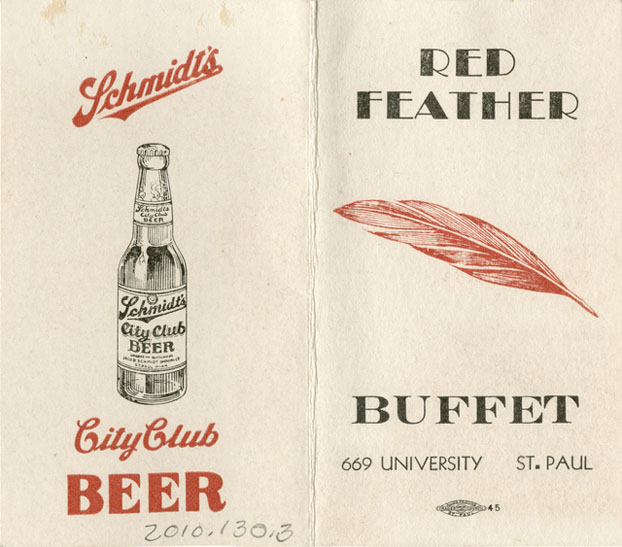
Image courtesy Minnesota Historical Society
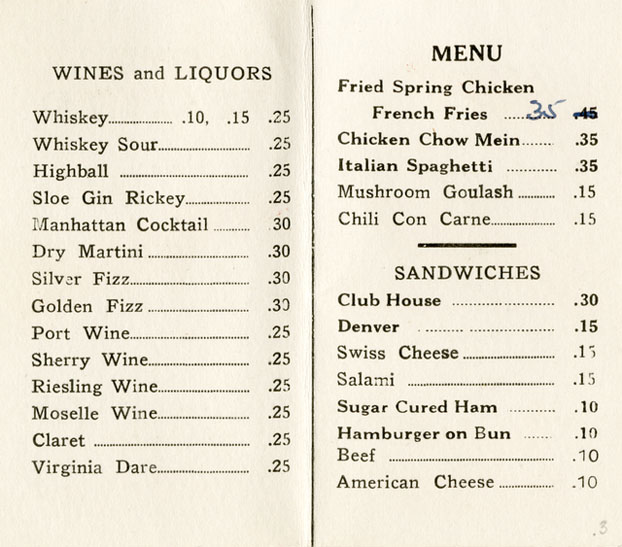
Image courtesy Minnesota Historical Society
Lake west of Lyndale. Became Inntimate (?) in 1973.
The Reef was a teen club located at Howie’s Bar, 2119 W. Broadway in North Minneapolis.
The 67′ by 88′ building was built in 1914 and originally held a hardware store on the first floor and the Crystal Commercial Club on the second floor. Dances were held by the Club. Sometime between 1927 and 1930, the second floor became the clubrooms of the West Broadway Commercial Club.
HOWIE’S
It appears that the first floor became a “beer parlor” in 1936; it was definitely Howie’s by 1938. A 1979 article describes Howie’s:
This is a North Side institution, the premier drinking place on the long and winding road that is Broadway. A job in the street creates a uniquely shaped, big building that is a warehouse of memories. The walls are festooned with hundreds of artifacts: tinted picture postcards, stuffed buck’s heads, large household implements, soldiers’ helmets, tin mess kits, World War II posters (a dead GI lying on a beat, waves lapping at his pant leg, with the caption “A Careless Word, A Needless Death”), and dozens (to us) unidentifiable objects. (Mpls. St.Paul, July 1979)
THE REEF
In December 1963, Howie’s became a dance hall and was given the additional name of The Reef, specifically set up with a tropical atmosphere to provide a warm and fun place to to during the winter months. One of the bands that appeared there was the Treblemen, a surf band with Dennis Libby, Randy Resnick, Bob Cohen, and Mike Mock.
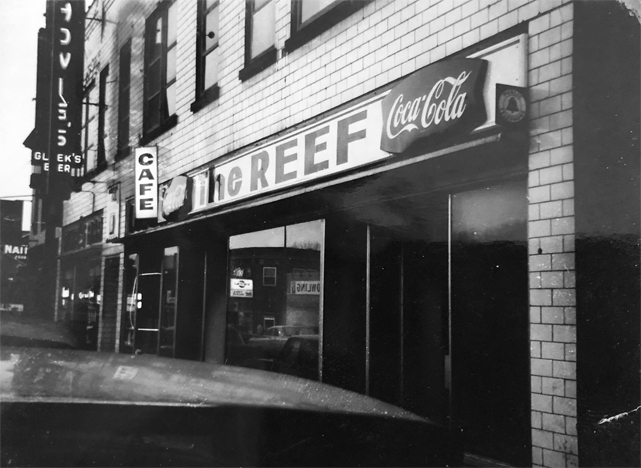
Photo courtesy Dennis L. Libby
Howie’s never really stopped being Howie’s, and in 1979 there was a reference to Howie’s dance hall.
In about 1985 the first floor became the DeLisi’s restaurant, and the second floor was DeLisi’s banquet room.
The Regal Tavern was located on 7th Street and Olson Memorial Highway in North Minneapolis. Owner James T. Fuller, Sr. brought in blues acts like Mojo Buford. Also known as the “Bucket of Blood” for all the fights. Fuller moved his business to the Cozy Bar.
The Registry Hotel was located at 7901 24th Ave. S in Bloomington.
The 14-story hotel opened in January 1975 with over 300 rooms.
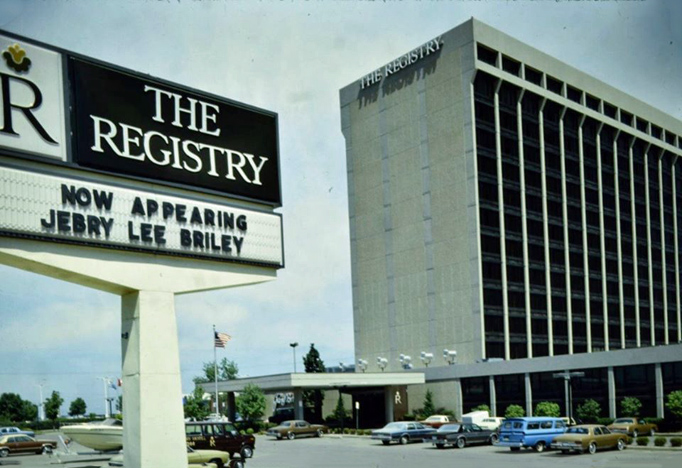
Registry Hotel circa 1980. Jebry Lee Briley was on the country charts in 1982.
With its size and proximity to the bustling 494 Strip, Airport, Carlton Celebrity Center, and the Met Sports Center, the Registry During was a common stopping place for celebrities, who stayed on its VIP Floor. One former employee wrote:
Entertainers stayed there when performing at the Carlton Celebrity room. Baseball and hockey players in town to play the North Stars at Met Center and the Twins at Met Stadium also stayed there. I waited on a number of celebs and members of sports teams. Vikings would come in sometimes on Sunday’s before a game and eat a big breakfast.
The Grand Portage Restaurant and Saloon was the name of the music venue, featuring Jerry Mayeron’s Big Band.
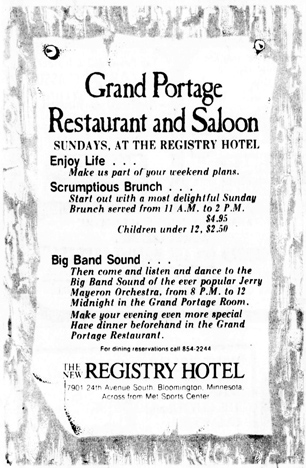
Minneapolis Star, September 12, 1975
Le Internet says that Prince and Morris Day performed here on March 16, 1983.
1984 – 1990: Ravels Nightclub
1994: LaTour Restaurant
On February 1, 1994, the hotel was renamed Mall of America Grand Hotel
The Registry was demolished in November 2004 when the MSP Airport built its north-south runway in October 2005. It and the Sheraton Motor Inn were directly in the path.
Thank you to the folks on the Flashbacks of Bloomington Facebook page for hipping me to this venue!
early Mike Waggoner and the Bops venue
The Ricksha was a Chinese restaurant located at 1910 Suburban Ave. in East St. Paul.
It opened in about June 1973, owned by Harry Wong. In 1974 it advertised for waiters and waitresses who were off-duty or ex “stews.”
By 1979 it had a disco downstairs.
In February 1982 it reopened under new management as Szechuan Taste.
From July 1986 to December 1990 the building was a Best Buy Superstore. It also had a Great American Music record store within.
In 2003 the building was used as a Catholic Charities furniture warehouse.
Since 2009 it has been a Plasma Center.
Ritz Hotel, 122-130 Washington Ave. So., Minneapolis. Built in 1925. The ad below is from October 21, 1932. At the Spanish Village a 7-course steak or chicken dinner could be had for $1. The place also had private bungalows for parties.
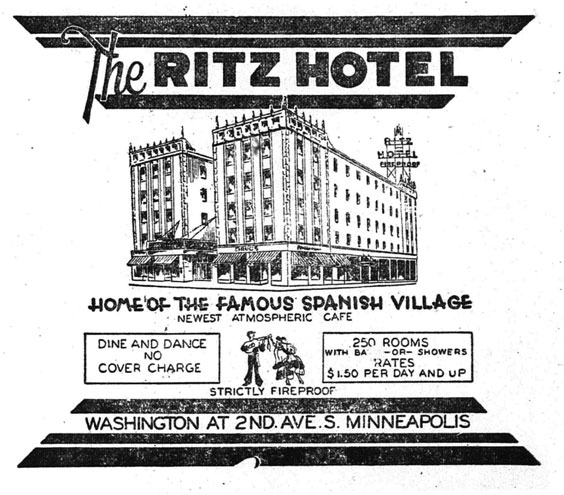
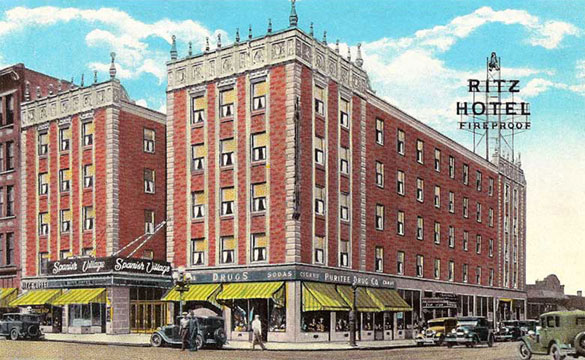
By 1952 the hotel was called the Minnesotan and the Manager was Aaron Robushin.
The address was listed as 324 – 2nd Ave. So. Venues included:
- South Seas Bar
- Panther Room. In 1952 Robushin wanted to turn this into a Hawaiian-themed room, but the Nicollet Hotel beat him to it. Or was the South Seas Bar his Hawaiian room? A 1952 performer in the Panther Room (love that name!) was Weela Gallez, who purveyed the “spiciest humor in town.”
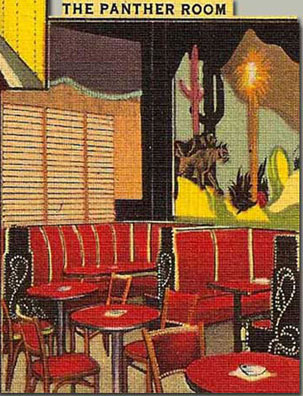
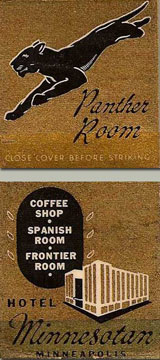
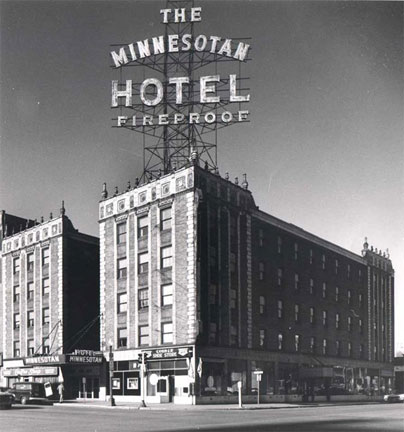
The hotel was demolished in 1963.
9510 Lyndale Ave. No. In 1967-69, Tommy Thomas trio, dancing nightly.
The River Road Club was located on the banks of the Minnesota River in Mendota. Dave Byrne found the ad below dating from 1945, but there is evidence of a River Road Club Orchestra in 1934.
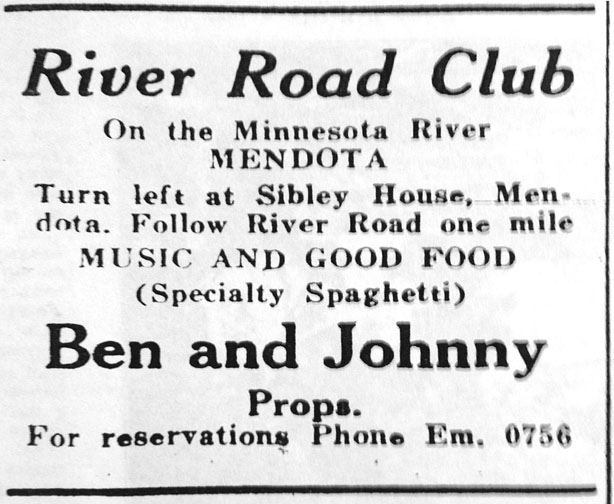
Ad dated August 1, 1945 courtesy Dave Byrne
In 1951 Augie Garcia and drummer Jesse Lopez opened with a small jazz group playing a Shearing style. The band broke up a few months later, when the men were called into service. In 1954 the group returned but never sold very well as a jazz band. Their conversion to rock ‘n’ roll brought them considerable success. Read much more about Augie Garcia Here.
In 1955 there was a terrible accident at the club, when a car with six women inside plunged from the parking lot into the Minnesota River. One woman was rescued and the other five died.
The club burned in 1962.
The actual location of the club has been difficult to pinpoint. Dave Byrne has done research for an article he is writing:
The Minnesota River had major flooding in 1965 scouring the area under the bridge. Soon after that the Corps. of Engineers decided to reroute the main channel for better barge navigation. Since that happened, the map from 1955 is different from the map after 1966 because the channel moved. The road used before 1965 appears to be gone. I asked Fort Snelling Park rangers to locate the club. They pointed me to Picnic Island in the State Park.
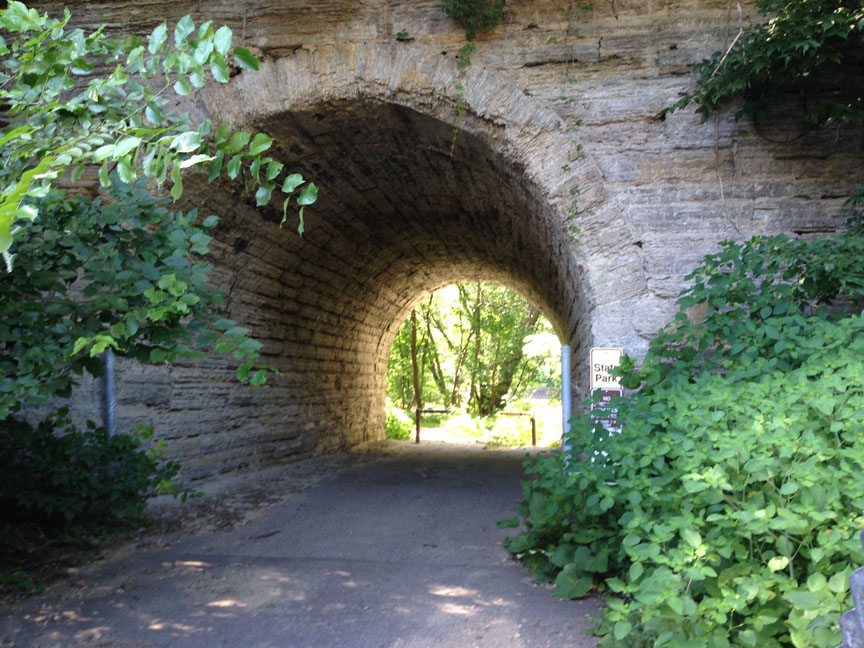
Save
This venue was located on the second floor of the clubhouse of the Minnesota Boat Club, 1 Wabasha Street, Navy Island, under the Wabasha Bridge in St. Paul.
NAVY ISLAND
The original name of the island where the River Serpent was located was Raspberry Island, named for the wild raspberries that grew there; the name appeared on the first map of downtown St. Paul in 1851.
The name Navy Island came from the fact that the U.S. Navy built a small base on the eastern side of the island, which was used between 1949 and 1968.
William A. Levin says:
This base used by the Coast Guard Auxiliary during WWII. Liberty Ships were being built at Port Cargill in Savage, and B-24s were being outfitted at Holman Field in St. Paul. Therefore the Coast Guard used volunteers to patrol stretches of the Mississippi and Minnesota Rivers for saboteurs. My grandfather, David S. Levin, was one of many Coast Guard volunteers. He felt he had to do something to support the war effort and his two sons in the Navy in the Pacific. He would have about age 55.
The west side of the Island was owned by the Minnesota Boat Club.
In 1995 the St. Paul City Council passed a resolution changing the name back to Raspberry Island.
As it was literally an island on the Mississippi River, it was prone to flooding, and several times it was cut off from the mainland. A couple of venues somehow tried to keep running, even without access, which is part of the fun of this story.
THE MINNESOTA BOAT CLUB
The Minnesota Boat Club was founded in in 1870 with ten members, including brothers John and Charles Corning, who had come to St. Paul from Brooklyn in the late 1860s. By 1885, the Club included the elite of St. Paul, including budding architect Cass Gilbert, who would design the Minnesota State Capitol and the U.S. Supreme Court Building; Lucius P. Ordway, head of 3M Corp.; and William Merriam, the Governor of Minnesota in 1889.
The first boat house was a floating affair, prone to leaking and threatening to sinking. Rowing became a national craze by 1870. A more substantial boathouse was completed in 1874. The current boathouse was built in 1910 and was placed on the National Register of Historic Places in 1982. But as other sports grew more popular in the late 1800s, the Boat Club fleet fleet fell into disrepair. (Curt Brown, Star Tribune, August 29, 2021)
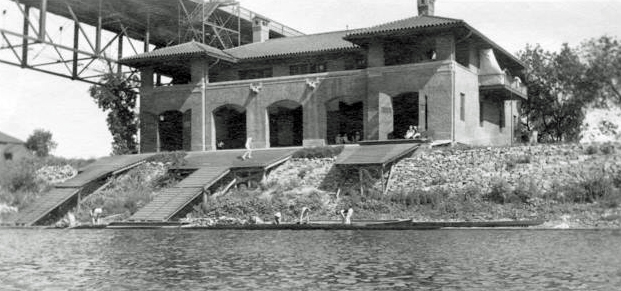
Minnesota Boat Club, 1915. Image courtesy Minnesota Historical Society
TUGBOAT ANNIE’S
Tugboat Annie’s was alternately described as a restaurant, bar, and sometimes nightclub. Will Jones, the Minneapolis Tribune columnist who tells all, informs us that the establishment opened in December 1950, and that it was run by Harold McEvoy, “who also owns a couple of breweries.”
Jones helpfully also tells us that the space had been the Minnesota Boat Club’s locker room, but interest in regattas has been lagging, so the Boat Club planned to remodel the ground floor to include their locker rooms. McEvoy joked, “Yeah, we’ve got an oarhouse downstairs.”
McEvoy used the terrace on nice days, and in May 1951 had plans to install a beer garden and barbeque pit on the west end of the Island. (Minneapolis Tribune, May 8, 1951)
The ad below was run several times, and always the same.
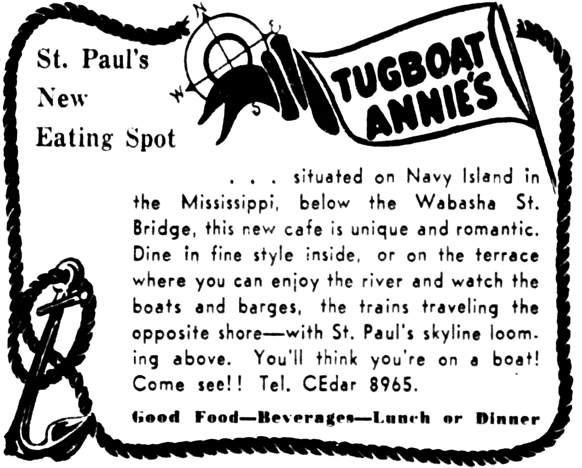
Minneapolis Tribune, August 16, 1951
Annie’s Needs a Tugboat
The first of the big floods that affected venues on the Island occurred in April 1952, but the Minneapolis Tribune reported that it hadn’t stopped business; in fact the restaurant was capitalizing on the situation with a sign on the roof telling patrons that it was a great place to get a look at the flooding river. Access to Annie’s was made by an iron stairway and across a small iron bridge. The bar sold a “flood cocktail” – just plain water.
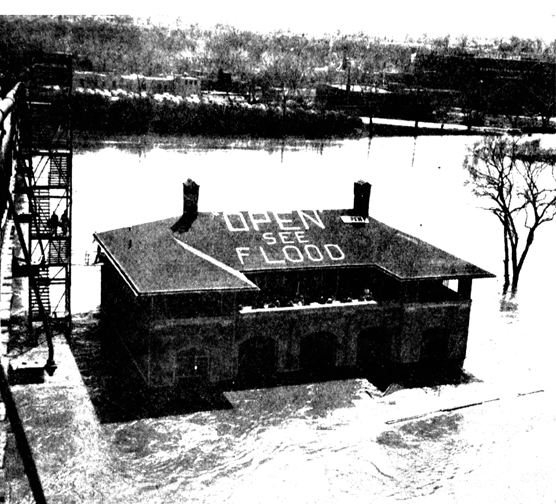
Minneapolis Tribune photo by Paul Presbrey, April 17, 1952
Trouble at Annie’s
To prevent inflation during WW II and the Korean War, in 1942 President Franklin D. Roosevelt created the Office of Economic Stabilization. Within that organization was the Office of Price Stabilization (OPS), which set maximum prices that could be charged for certain items. One of those items was beverages at cafes, and Harold McEvoy was accused of overcharging for drinks and not keeping proper records by the OPS. In January 1953, the office filed an injunction seeking treble damages of almost $43,000 for overcharges amounting to over $14,000. The injunction prevented McEvoy from doing business until he complied with the OPS record keeping requirement and reduced his drink prices.
Then in June 1953, the IRS tacked on a tax lien on McEvoy’s properties, seeking over $3,000 due in withholding and employment taxes from September 1952 to June 1953. Previous liens from 1952 totaled more than $100,000; apparently McEvoy owed a boatload of taxes for 1945, 1946, and 1949. All of his properties had been seized, and the Government auctioned off the furnishings and supplies of Tugboat Annie’s in July 1953. I hope he had fun while it lasted.
INSIDE ANNIE’S
That should have been the end of Tugboat Annie’s, but a photo just came up on Facebook showing the “Bar at Minnesota Boat Club,” 1960. There were no more ads I could find, but maybe someone else took it over? Maybe the Boat Club itself? Maybe it’s just misdated? At any rate, thanks to Michael Larkin for finding it, and to Jen Conner for noticing the “writing on the wall” that I missed!
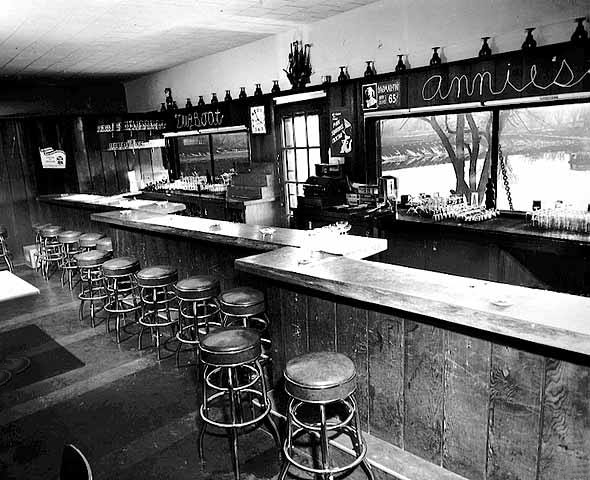
Photo courtesy Minnesota Historical Society
Harold Francis McEvoy
This nefarious behavior on the part of our friend Harry made me curious, so I did a little sleuthing on him. It appears that he was born in 1907 in St. Paul, the eldest of six sons. He served for 18 months in the Army during World War II (1942 – 1943) and was discharged as a CP1. He died in 1965 at the age of 58.
He had been in trouble before. In 1945 he bought the Hartig Brewery in Watertown, Wisconsin. In 1946, the US District Attorney announced that 1,703 cases of his beer were destroyed because the FDA declared that it was adulterated by a type of acid resulting from the use of molasses.
In 1947 he was arraigned in US District Court for criminally violating the war food order from June 1 to August 31, 1946. The complaint was that the Hartig brewery used more grain and syrup in making beer than permitted under its quota. McEvoy’s only defense was that he bought the syrup under the impression that it was molasses, which is not subject to the limitations of the food order, and used extra grain when some mash was spoiled in an accident in the brewery. But the assistant US Attorney said accused McEvoy of falsifying records and making an elaborate effort to obscure the violation. McEvoy was personally fined $3,000 each on two counts each, and the company was fined $1,000 for each count.
Then, in January 1948, described as the “former owner and manager of the Hartig Brewery,” McEvoy was fined $150 in Madison Federal court for shipping adulterated beer in interstate commerce. McEvoy pleaded no contest. The beer was adulterated by use of a “short cut” that was used by some brewers to avoid the expense of pasteurization. The brewery was in bankruptcy at the time, and the judge assessing the $150 fine took into consideration the $48,000 McEvoy had spent trying to correct “deplorable” conditions at the brewery after he bought it in 1945 and the $6,000 fine he had paid for the 1947 violations.
Oh no. In February 1948 a Federal court fined him another $2,500, after he pleaded guilty to concealing 102,180 pounds of grains spirits which he had marked as molasses back in 1946. He was given 90 days to pay the fine.
And in 1949, in the mess of bankruptcy, the receiver of the Hartig Brewery sued McEvoy and others for alleged fraud in connection with the purchase of the brewery from the members of the Hartig family back in 1945.
But hey, let’s charge ahead and open a restaurant!
THE GOLDEN GARTER
On October 31, 1961, Will Jones announced that Tugboat Annie’s had been taken over by new owners and renamed the new 3.2 bar the Golden Garter. It was redecorated with a red and gold interior with a mixture of touches from the 1890s to the 1920s.
It will be a kind of place where customers are encouraged to sing and to throw peanut shells on the floor. The place will be co-managed by Phil Greenberg, Minneapolis clothier, and Ken Wingard, a St. Paul fuel oil man, who have done much of the work on the place themselves.
The Golden Garter opened on November 3, 1961.
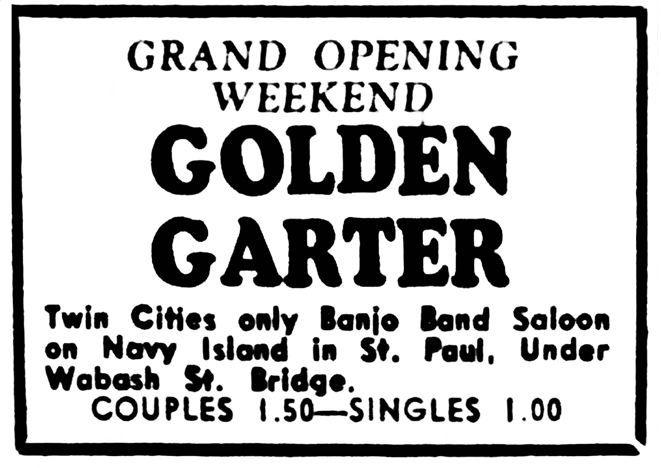
Minneapolis Star, November 3, 1961
The Minneapolis Daily Herald, which took over when the Star and Tribune were on strike in mid-1962, filed this report on June 28, 1962:
It’s New Year’s Eve every Friday and Saturday night at the Golden Garter… At midnight the noisemakers are passed out, the lights are dimmed as Dave Wesley and his Levee Loungers strike up “Auld Lang Syne” on their banjos. According to owner Phil Greenberg, the place has been jumping since they opened the doors last November. And though they’re open only four nights a week (Thursday-Sunday), the folks who join in the sing-alongs and devour 35-45 pounds of salted-in-the-shell peanuts each night also sip enough 3.2 beer to make the Garter’s weekly total consumption of suds one of the top in the state. To induce the boys to go where the girls are, and vice versa, tonight, and every Thursday is lady’s night, with no cover charge for the gals.
The Levee Loungers Make a Record
Vic Burton, Night Beat, Minneapolis Daily Herald, July 23, 1962: [Vic was a good reporter, but repeatedly referred to the Golden Garter in this story as the Red Garter, which he apologized for later. The Minneapolis Daily Herald was not known for the best reportage…]
Peanuts, Brew, and the Levee Loungers: Things will be hopping this Thursday, Friday and Saturday night at the [Red] Garter in St. Paul. The Audio Fidelity recording company is cutting an album of the Dave Wesley Levee Loungers these three days, and rumor has it that the boys are set to make it big on the national scene. Audio Fidelity no longer has the Dukes of Dixieland, and the company is planning to give the [Red] Garter boys a big promotional campaign. The actual recording is being subcontracted to Dave Hersk at Gaity Studios, and Sidney Frey, president of the Lampoon, is handling the album direction. The album is set to be released Oct. 1. About 12 microphones will be used during the session, allowing not only picking up the sounds of the Levee Loungers, but also excellent pick up of the audience, since the audience in effect has a part of the show.
From Bob Murphy, Minneapolis Star, December 18, 1962:
A new LP Stereo Hi-Fi record out here is that of the Levee Loungers, who made a name for themselves at the Golden Garter in St. Paul, where the stuff was recorded with some sing-along audience participation and off-the-cuff lyrics. The bunch includes piano, drums, sousaphone, and three banjos. Remember when Mike Pingatore used to hold up the banjo section alone with the Paul Whiteman band? And how long was it that you didn’t hear a banjo played at all, except with pennies under the bridge so it would sound like a guitar? The instrument seems to have come back into its own. This material is about as subtle as a bung-starter, but it’s adept and lively.
A bung-starter is a hammer used to pound a bung (plug) out of a barrel. I had to look it up.
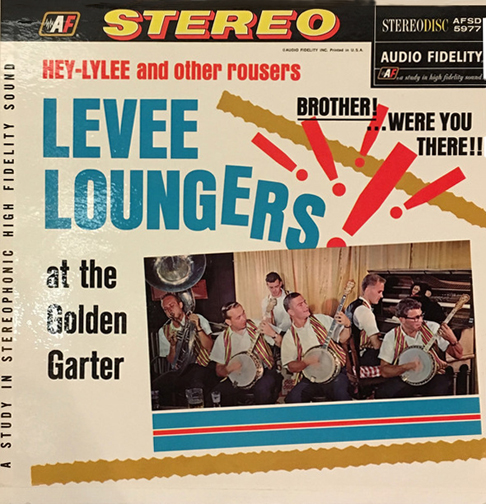
Songs on the record are:
Side 1:
- Hey Lylie
- Daisy-Sidewalks of New York
- Bill Baily
- Cotton & Corn
Side 2:
- Five Feet Two
- Heart of my Heart
- I’ve Been Working on the Railroad
- Wait ’til the Sun Shines, Nellie
- If You Knew Susie
- New Year’s Eve
Four copies of this fine recording were available for $5 plus shipping as of September 2020.
Identical, nondescript ads ran for the Golden Garter until the one below appeared in October 1962:
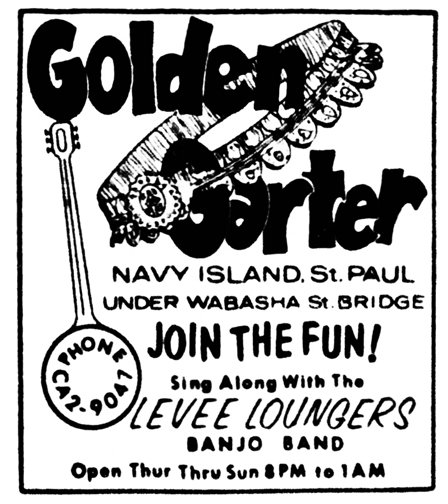
Minneapolis Star, October 19, 1962
Access Problems
Getting to the Garter was difficult enough, but in November 1962, Don Morrison of the Star reported that the Army Corps of Engineers was building a flood-control levee on the southern bank of the Mississippi River opposite Navy Island. This changed everything in terms of getting to the club.
Formerly, one stalked the Golden Garter by crossing the Wabasha bridge, turning left at its southern extremity and then turning left again down a bumpy road leading to a rude bridge that arches the flood to Navy Island. This route now will lead you smack into the levee.
In 1964, it looks like management briefly tried some of the fads,
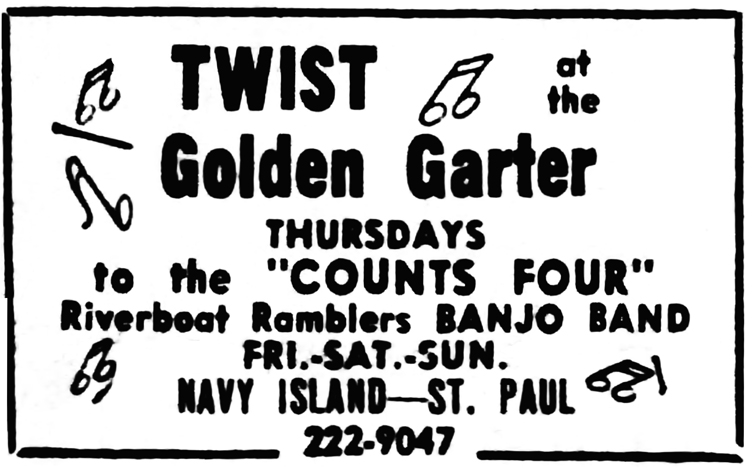
Minneapolis Star, April 9, 1964
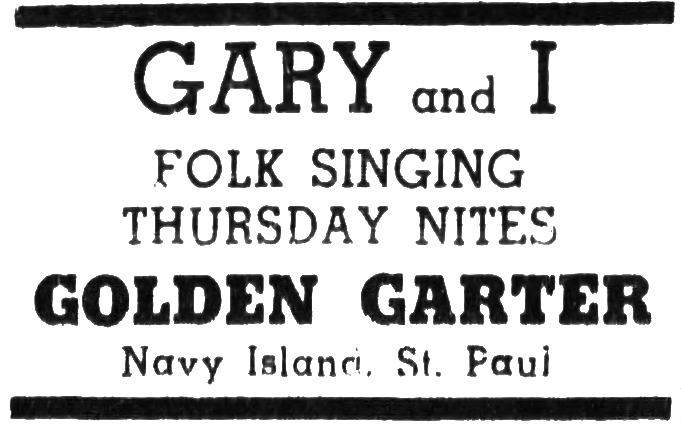
Minneapolis Tribune, November 12, 1964
… but always returned to its core audience-pleaser, jazz.
Kid Thomas Brings the (Boat) House Down
Back up to August 20, 1964, when Kid Thomas Valentine brought his “delightfully soulful New Orleans jazz” to the Golden Garter. Allan Holbert of the Minneapolis Tribune described it:
With several hundred people jammed into the Golden Garter, it was hot and sweaty before the band started playing, and the music did very little to cool things off. You could feel the place throbbing as soon as they moved into the likes of “Kid Thomas Boogie,” “Algiers Strut,” and “St. Louis Blues.”
Thomas brought only three of the musicians who were with him last summer when he played a series of concerts in the Twin Cities: Sammy Penn on drums, Manuel Paul on tenor sax and Joe Butler on bass. But four members of Minneapolis’ own Hall Brothers Band demonstrated an amazing grasp of the early New Orleans style as the augmented the quartet. They were Stan Hall, piano; Mike Polack, banjo; Butch Thompson, clarinet; and Russ Hall, trombone.
Holbert fled to the cooler Prom Ballroom to catch Count Basie, “Just before the pulsating Navy Island shook loose and began to float down the Mississippi River.”
“Navy Departs, Pub Fights On”
Such was the headline on April 13, 1965, during yet another flood, this one of catastrophic proportions. 1965 suffered record late snowfall, resulting in horrendous floods of epic proportions. As the Navy worked for three days to prepare the Naval Reserve Unit buildings on the Island against the rising waters, it became clear that the waters were going to win, and the buildings were evacuated, some by boat.
Meanwhile, at the Golden Garter, part owner Jim Drake “scrubbed down the bar with vigor, glancing nervously out a broad window at the surging stream.”
“We’ll be open till the power shuts off,” he said. Outside a painter whistled while applying huge white letters on the red roof: “Open as Usual.”
At noon three members of the four-piece band crawled out on the roof and played a set or two to let the customers know the old Golden Garter wasn’t licked yet.
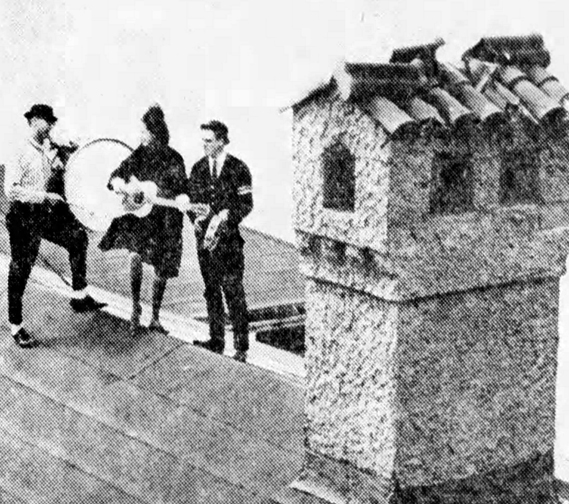
Minneapolis Star, April 13, 1965
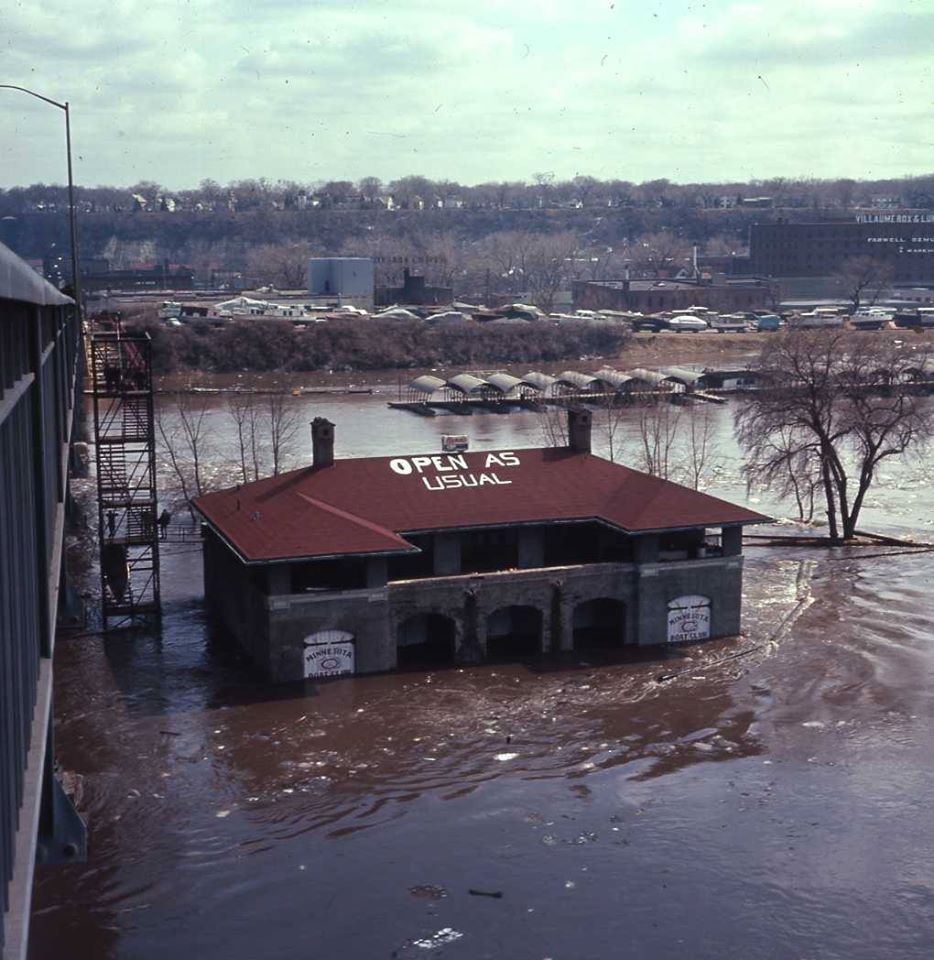
Photo courtesy Eric Larson
This was the last ad I found for the Golden Garter:
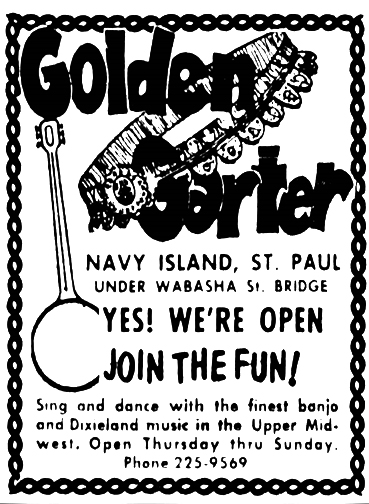
Minneapolis Tribune, June 16, 1966
The property was put up for sale in March 1967.
JIMMY’S ON THE LEVEE
This must have come from Facebook; if I’m quoting you and not giving you credit, please contact me.
In the spring of 1967, Jimmy Theros (Restaurant owner in St. Paul), Shirley Erdman (Insurance Executive) and Dave Wesley (Dentist/Banjoist) met for their customary lunch at Jimmy’s Highland Park Restaurant.
For the past few weeks they had been discussing re-opening the old Golden Garter restaurant. Dave had performed there in the early ’60s as leader of the Levee Loungers before going on to Diamond Jim’s, after which he retired from the music business to pursue his dentistry career full time.
Jimmy’s opened on November 3, 1967. Throughout its tenure it appeared to be open on Fridays and Saturdays only. The house band was Dave Wesley and his Barbary Coast Banjo Band.
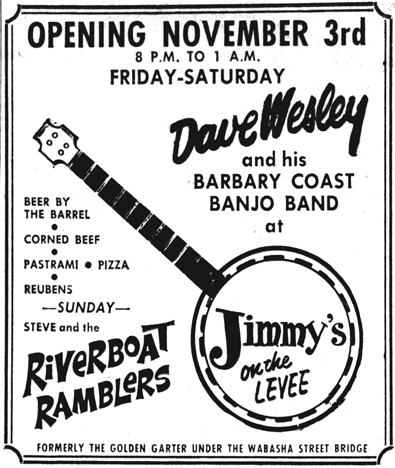
Minneapolis Star
Jimmy’s seemed to be plagued by stops and starts. No record of the first closing, but the first re-opening was on October 31, 1969.
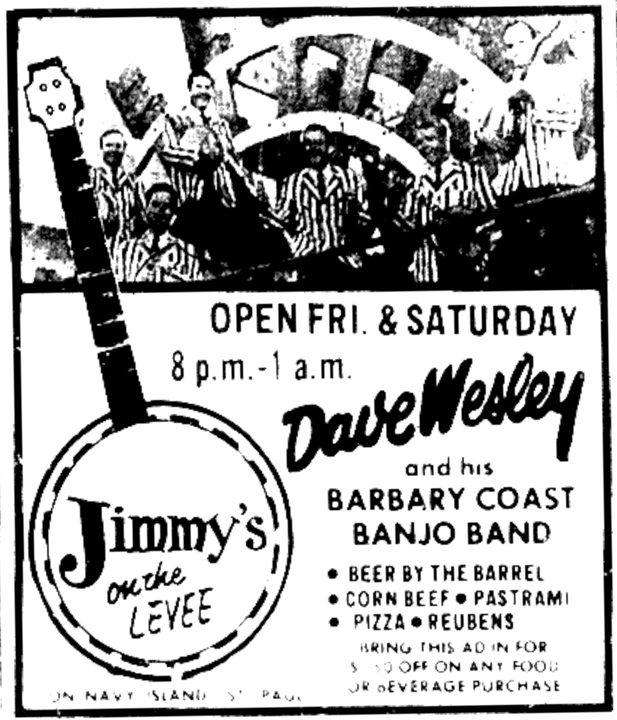
June 18, 1971
Jimmy’s on the Levee closed again on July 1, 1972.
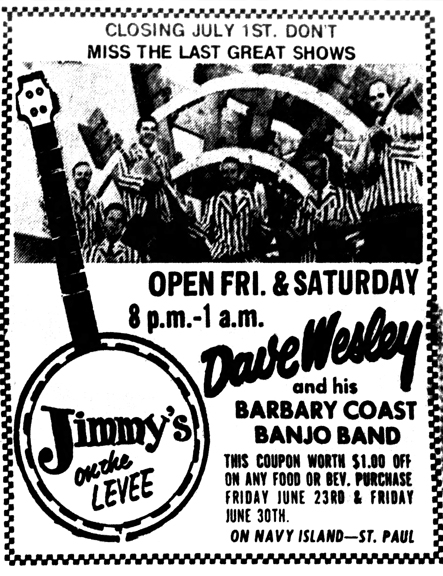
Minneapolis Star
But you can’t keep a good banjo down, and Jimmy’s re-opened yet again on October 27, 1972.
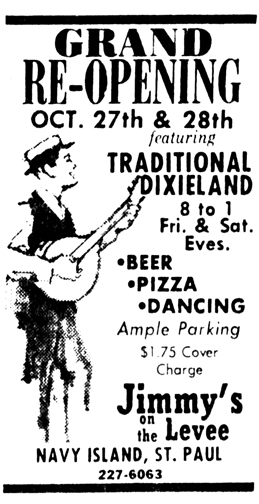
Minneapolis Star
But Jimmy’s finally gave up the ghost for good. Here’s the last ad I found:
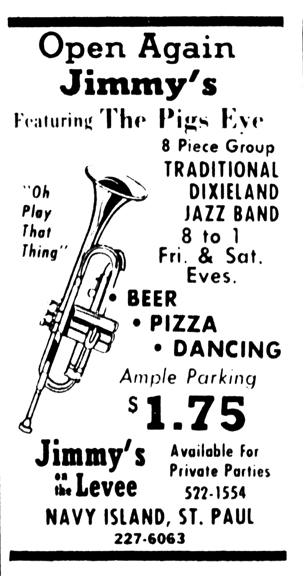
Minneapolis Tribune, November 24, 1972
THE RIVER SERPENT
Co-founder Jim Watson describes the beginning of the River Serpent:
I was hitchhiking back from San Francisco after finishing up playing with Dan Hicks. Jack Seel and Eddie Holmers, old friends, picked me up. The three of us opened the River Serpent in 1973 for $750 with aid from Ted Hamm of the Hamms Brewery. I was referred to as the Captain and sang, played, and drank there, as well as lived there, every day and night. I primarily put the bands together to sing with them. I never loved anything more. The music continued on and on with great Blues and jazz and is still spoken of with reverence and love!
A mention in the paper in September 1973 called the River Serpent “the new Sunday in-spot (on Marine Island).”
Jack Seel, a photographer, and Eddie Holmers, have both passed away.
Drummer Scott Sansby remembers that the stage was a good 12 feet above the dance floor, and we had to climb a ladder and go through a trap door to get up there.
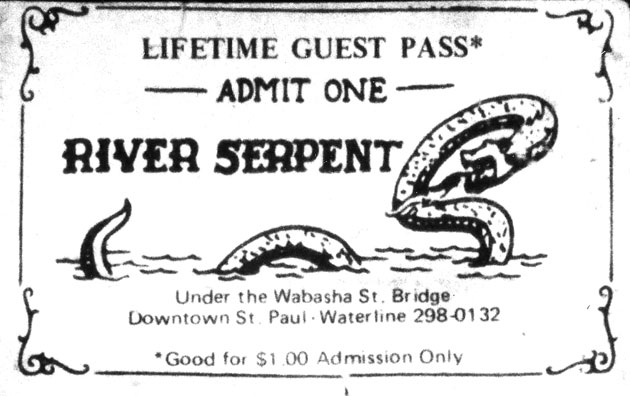
The Serpent was famous for its elaborate calendars, although the fabulous artists didn’t think to include the years for historians!
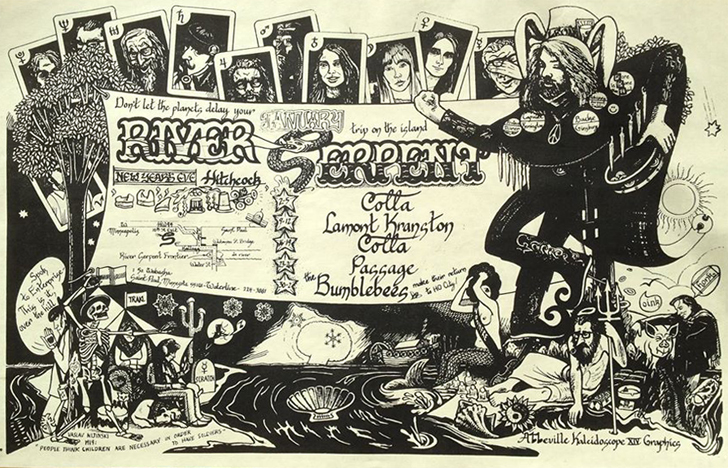
A January calendar courtesy Jim Watson
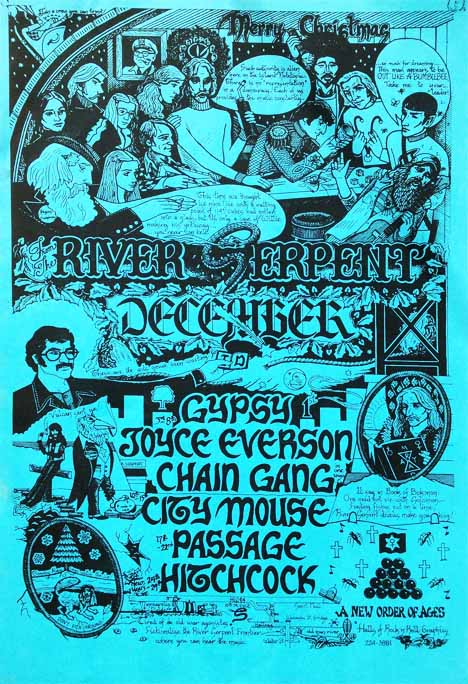
Poster courtesy Jim Watson
Mojo Buford Blues Band at the River Serpent, September 1974. Russ ” Bucko ” Williams on drums, Billy Black on bass, Dave “Cool Breeze” Brown.
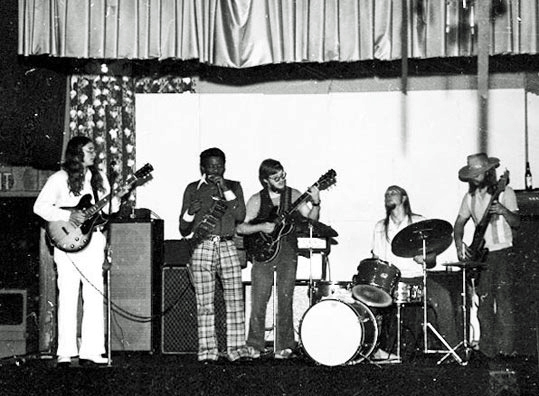
Photo courtesy Will Agar via Robb Henry.
The Shakey’s of Rock-and-Roll Bars?
In the September 1974 issue of the Insider, Dean J. Seal reviewed the August 17, 1974, performance of Passage at the River Serpent. At the time, Passage consisted of (as listed in the review):
- Scott Sansby on drums
- David Miner on bass
- Jody Brown on congas, described as the backbone of their sound
- Bobby “Kinky” Schnitzer on guitar
- Bruce “Creeper” Kurnow on electric piano and harmonica (often at the same time)
- Richard “Junior” Dworsky on organ and electric piano [later of “A Prairie Home Companion” fame]
- Doug Maynard on vocals
- Gwen Davis on vocals
Seal was kind of viscous in his review of the Serpent, alleging that the band had to compromise its talent to play dance music that was beneath them in order to eat. Anything they’d rather do had to be snuck into the song, which didn’t really work. This was probably true of any group of accomplished musicians (they say Sha-Na-Na warmed up by playing progressive jazz), but likening the River Serpent to Shakey’s was pretty harsh! (I wonder if he even knew about the place’s banjo past…)
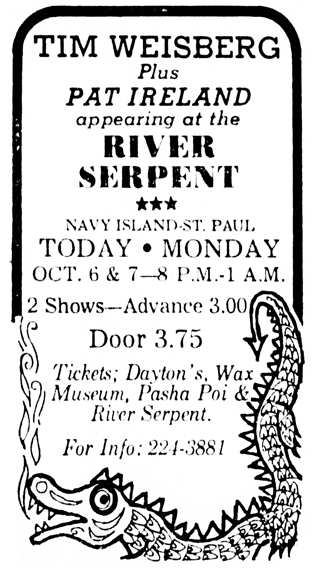
Minneapolis Tribune, October 1974
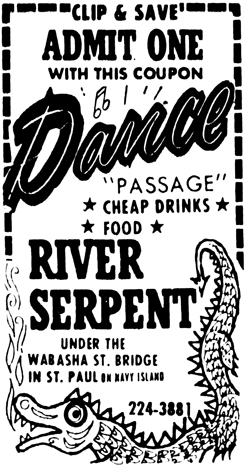
Minneapolis Tribune, January 12, 1975
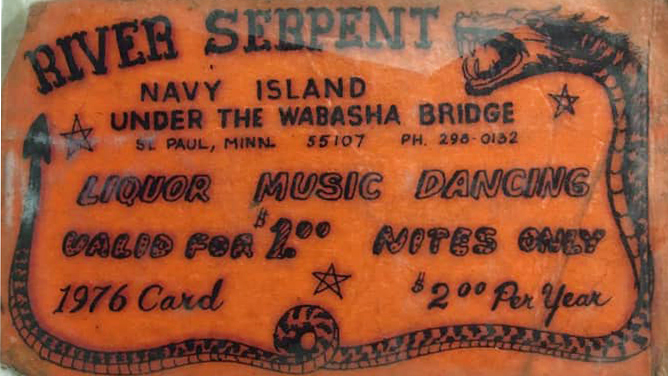
Bob Schmidt’s 1976 River Serpent admit card – $2/year!
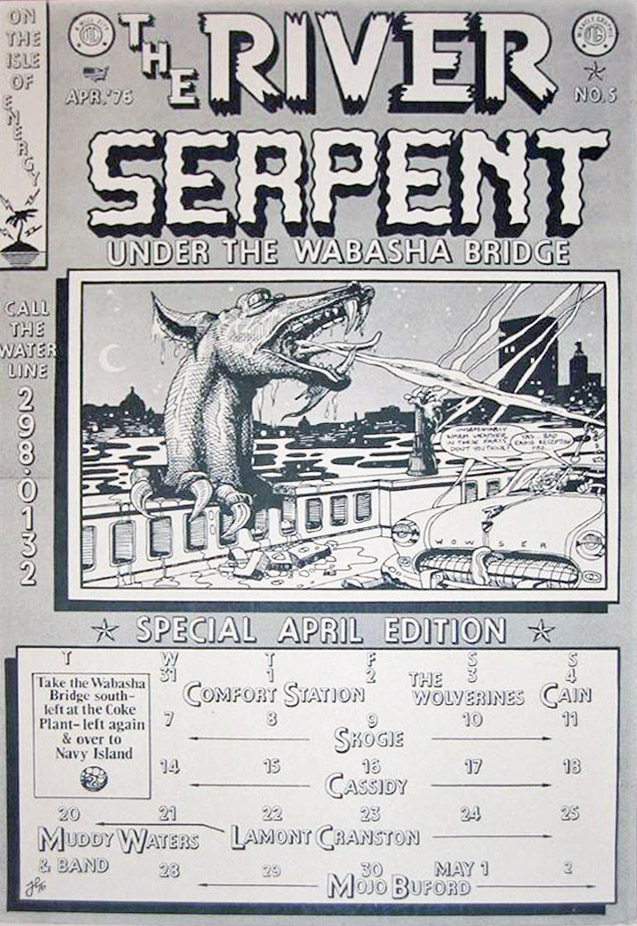
Calendar from April 1976 by Johnny Hanson, courtesy Rico Anderson
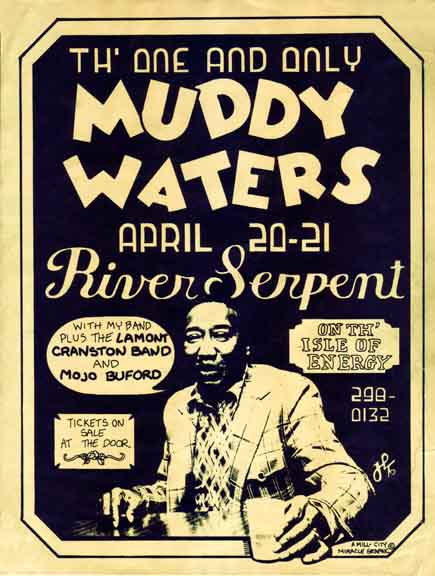
Muddy Waters poster by Johnny Hanson, courtesy Bob Fernow
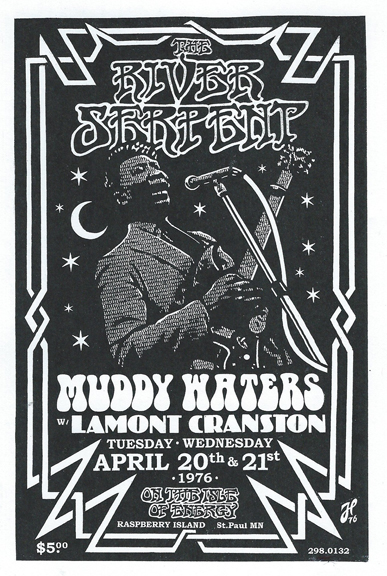
Muddy Waters II by Johnny Hanson, April 1976
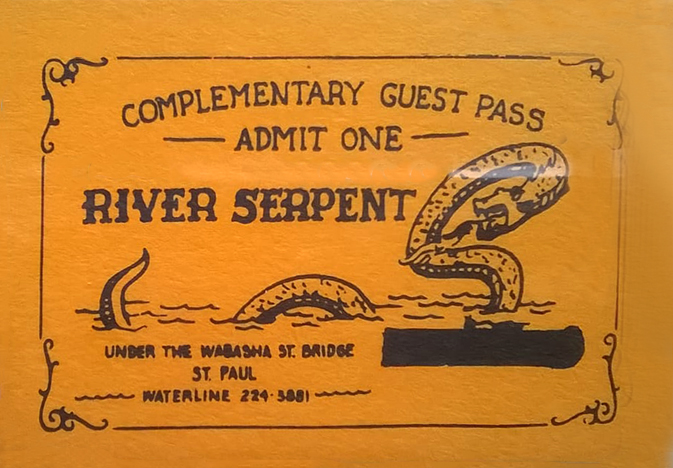
Guest Pass, courtesy Richard Anderson
My River Serpent Story
My one and only visit to the Serpent was on May 14, 1976. ‘Twas on that night that a 19-year-old Jeannie with a group of about 14 friends from the U of M took a ride on the Jonathan Paddelford, all dressed up in long dresses and suits and ties. That’s me, last girl on the right. (That guy on the far right was not my date!)
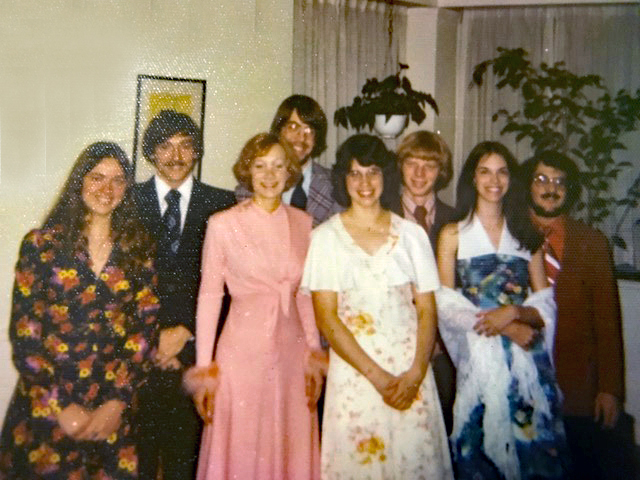
Photo courtesy Jan Linse Baldwin
From my journal I learned that we danced our butts off on the boat – everything from the Virginia Reel to the Bunny Hop. Afterwards, we somehow found ourselves at the River Serpent – how, I don’t know, since we were were all very broke and didn’t go to clubs. Anyway, we walked in, and the regulars were dressed in jeans and gave us the fish eye.
I sent this to four of my friends who were there, and although all these years I thought the band was Passage, Jim immediately remembered that it was Lamont Cranston. They were on a break when we got there, but we stood on the dance floor until they came back, and when they did, we just went nuts and danced our butts off some more! We loved to dance! I tore the hem out of my dress, it got so wild. It got hot in there, so we went “outside,” where ever that was, and continued dancing out there. It was the best band I’ve ever heard, and a night to remember always. Bless the River Serpent for a fabulous night!
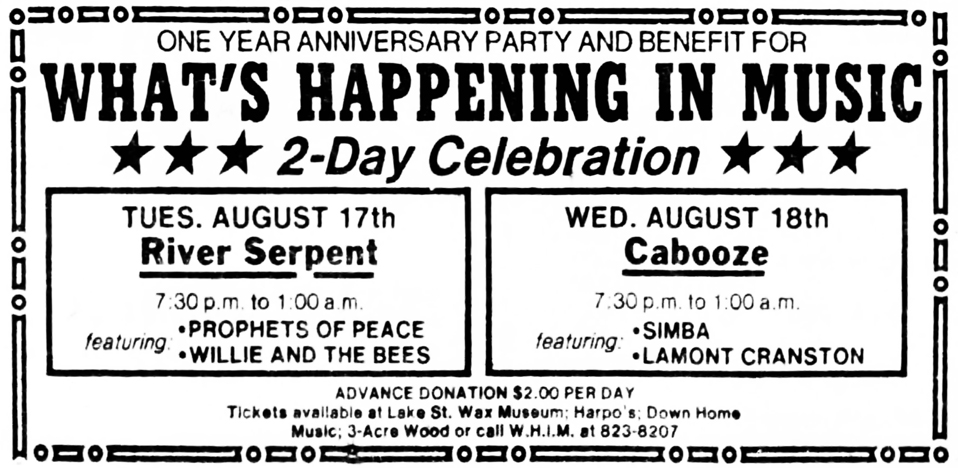
Minneapolis Tribune, 1976
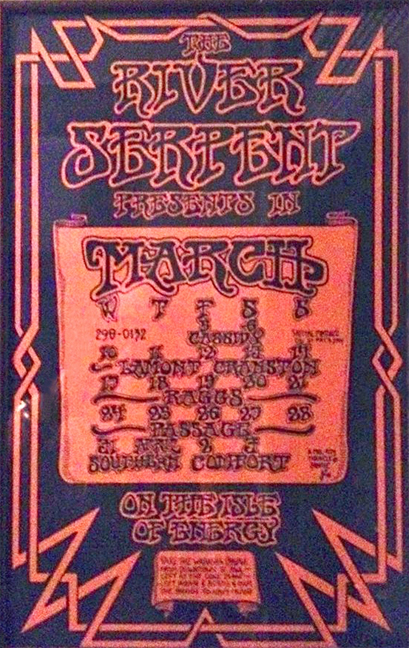
March, year unknown. “On the Isle of Energy”
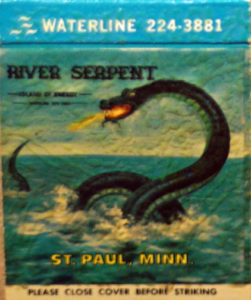
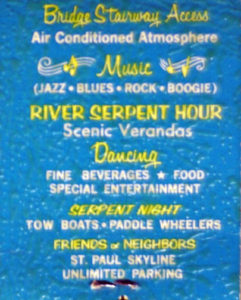
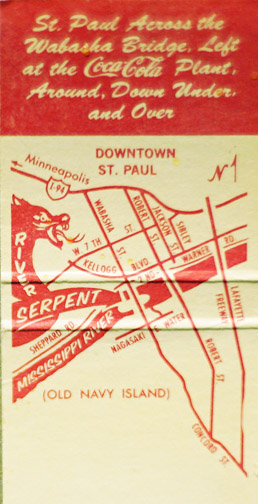
The last mention I found was in January 1977, when it was “closed for remodeling.”
ROCKIN’ ON THE RIVER
In the 1980s, the Island was the site of some major concerts.
The first was on May 21, 1983, and starred R.E.M. and the major local bands the Suburbs, the Replacements, and Phones.
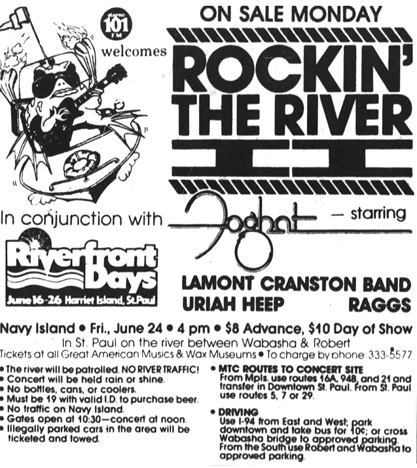
Minneapolis Tribune, June 5, 1983
In 1984 the series was expanded.
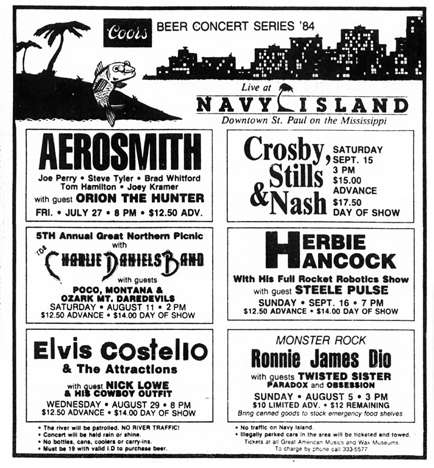
Minneapolis Tribune, July 22, 1984
The Navy Island concerts kind of petered out in 1984. The Elvis Costello concert was moved to the Orpheum, and CSNY was moved to the Minneapolis Auditorium. The Go-Gos had been added for September 9 but were then cancelled, as was Herbie Hancock. Only 7,000 people each came to see concerts by Aerosmith and .38 Special; Ronnie James Dio pulled 5,000, and perennial favorite Bonnie Raitt only drew 1,500. Promoter Randy Levy of Schon Productions said that the company suffered a six-figure loss. (Minneapolis Tribune, September 16, 1984)
The Boathouse is now a wedding venue as well as an active rowing club.
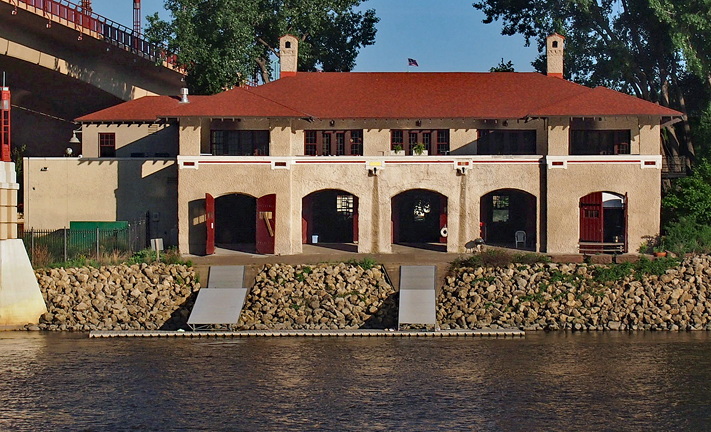
Boathouse in 2013Save
BUT THE BUILDING STILL FLOODS….

2019
The Riverlyn Inn was described in 1939 as on Lyndale Ave, 7 miles from Minneapolis. There was also a Riverlyn Park described as 5 miles from the city limits. Both hosted dances for the black community, advertised in the Minneapolis Spokesman.
Please see the Cozy Bar – Minneapolis.
The Riviera Club was in Riverside Park in Shakopee, 1938 – 1952.
1940: Dancing nightly by Loren McNabb and His Orchestra, featuring the Hammond Organ.
Photos below from the Shakopee Heritage Society.
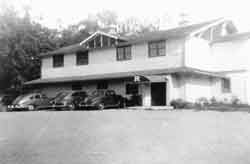
Riviera circa 1942
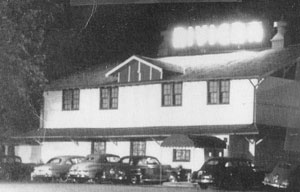
Riviera Club, Shakopee
Save
Road Buddy’s Bar-B-Que was started by Chet Oden, who also owned the Ebony Lounge.
There were several Road Buddy’s locations:
386 WEST CENTRAL AVE.
This was at Western Ave. in St. Paul, 1949. The building may have also been known as La Bongo Club at one time.
23 WASHINGTON AVE. N
This location was mentioned in a crime report in the Minneapolis Star, August 19, 1950.
2925 HENNEPIN AVE.
This Minneapolis address was advertised as a Road Buddy’s in the St. Louis Park High Echo in February 1953 and there is a news item from October 4, 1952 identifying G.V. Wallace as the proprietor. (Minneapolis Tribune)
799 UNIVERSITY AVE.
This location was also in St. Paul. The building was built in 1922.
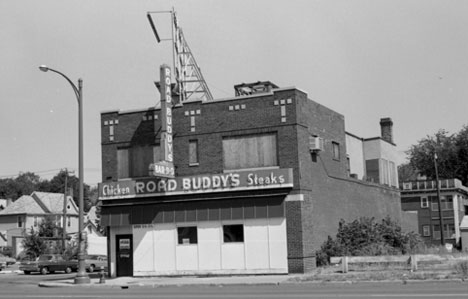
1975 photo of 799 University courtesy Minnesota Historical Society
The photo below indicates that the business dates back to at least 1950.
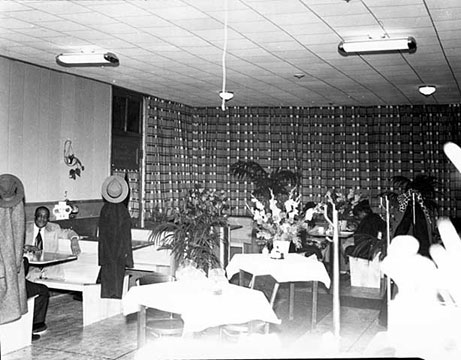
1950 photo of 799 University courtesy Minnesota Historical Society
THE EBONY LOUNGE
On the second floor of Road Buddies was an “after hours” venue that came to be known as the Ebony Lounge. In 1965 radio station KUXL took over this venue, turned it into an R&B disco with 14 “Go Go Foxes.”
A note in the Minneapolis Tribune dated December 10, 1965, said that “The discotheque scene at St Paul’s Ebony Lounge which disappeared a couple of weeks ago, is back in action, with much the same cast, at Big Al’s in Minneapolis. KUXL’s Preacher Paul is promoting it once more.”
From the beginning of 1966 to about March 1967, the Ebony Lounge hosted smooth rhythm & blues singers Bobby Lyle and Doris Hines.

Minneapolis Tribune, March 3, 1967
THE DEATH OF CHET ODEN
Chet Oden’s body was recovered on October 25, 1966, where he had drowned while duck hunting on the Sandy River, about three miles north of McGregor, Minnesota. He was 49.
When Chet Oden died, the 799 University location apparently shut down temporarily, but the ad below indicates that it reopened as Road Buddies Bar-B-Q and the Ebony Lounge on December 30, 1966.
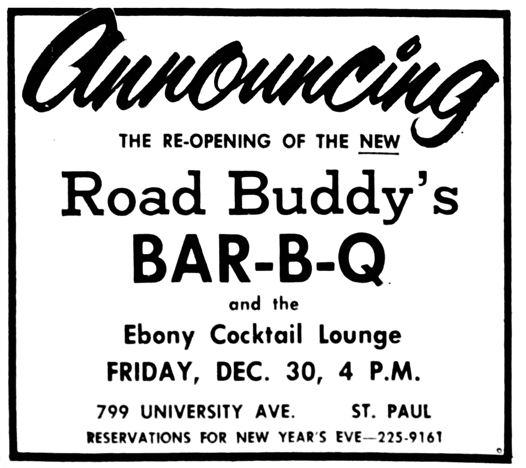
Minneapolis Star, December 28, 1966
Articles in 1969 were referring to 799 University Ave. as the Ebony Lounge, not Road Buddy’s.
On July 28, 1969, Elmer Caldwell, 44, was shot and killed in a gunfight in the Ebony Lounge when his gun got caught in his handkerchief. He was the manager of the Rondo and Dale Rec, 616 Concordia Ave.
SUBSEQUENT VENUES
HARATA KEY CLUB
On November 26, 1974, it was reported that there was something called the Harata Key Club operating in the basement of the building. It was raided by the police on the 24th, and 22 men, 18 women, and a 17-year-old girl were arrested. Liquor and gambling equipment were confiscated. Four people were charged with operating a disorderly house, but most were fined $25 and let go. (Minneapolis Star, November 26, 1974)
THE THREE PIGS
By September 1978 the place was a Barbeque place called the Three Pigs, which got a scathing review in the Minneapolis Star.
CATHAY ISLAND
In February 1981, Will Jones reported that the place had become a Chinese place called Cathay Island, that still served good ribs. (Minneapolis Tribune, March 7, 1981)
CARAVELLE
Chinese and Vietnamese Restaurant: September 1985 to at least January 1990.
NGON
Ngon Vietnamese Bistro: 2010
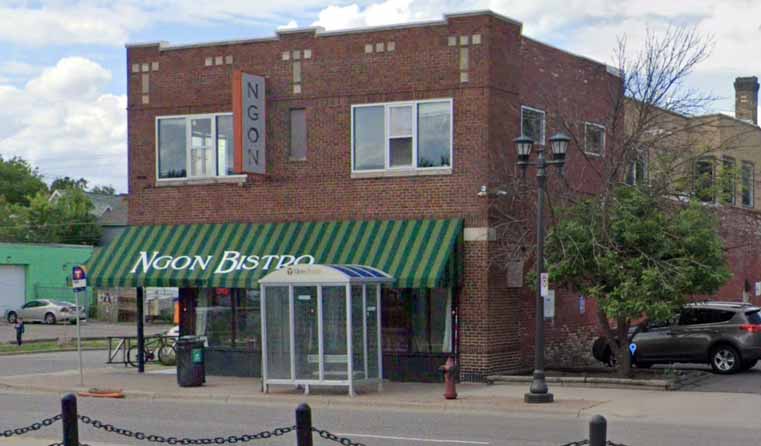
Ngon Bistro
1319 WASHINGTON AVE. SO.
In light of the bad reputation his Key Club was getting, Chet Oden changed part of it into a Road Buddy’s with country entertainment. This was in early June 1961. Will Jones reported that the country theme only lasted about two weeks and then the exotic dancers returned, along with the great rhythm & blues and the Key Club name. You could still get that Road Buddy’s famous Bar-B-Que at the Key Club.
TEXA-TONKA SHOPPING CENTER
This location was at 8120 Minnetonka Blvd. in St. Louis Park from about June 1966 to 1968. On June 19, 1967, the St. Louis Park City Council denied Road Buddys a request for a public hearing to request a beer license, citing a petition from 33 citizens opposing said license.
The Westphal Robbinsdale American Legion Post 251 was located at 3600 N. France Ave.
It was open from at least 1955.
The photo below is from before a stage was installed. Photoshop trickster Billy Fawcett added Clellan Card.
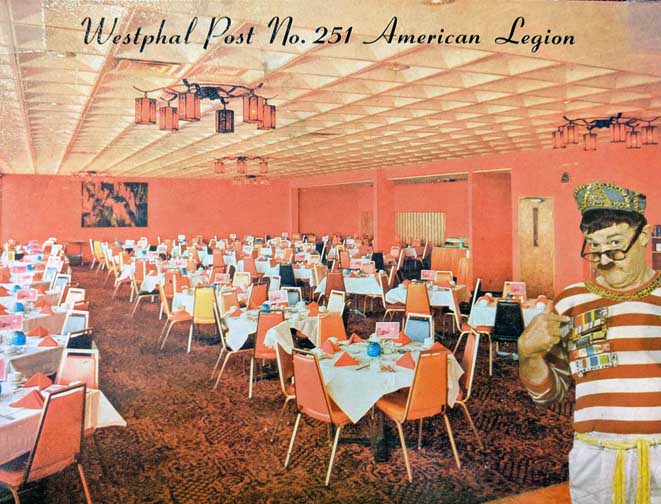
Photo courtesy Robbinsdale Historical Society.
Dances were held on weekends; bands included the Skylarks and the Harvey Hefren Band.
The building survived until at least 1996. In 2021, Parker Station Flats Apartments was built on the site.
This was a family place at 4639 Excelsior Blvd. in St. Louis Park, built by gas station mogul and home builder Robert Johnson in 1935, at the end of Prohibition. It was one of the early entertainment places that would center on Excelsior Blvd. This particular building would become the Swan Cafe.
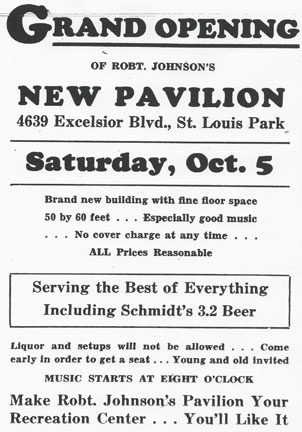
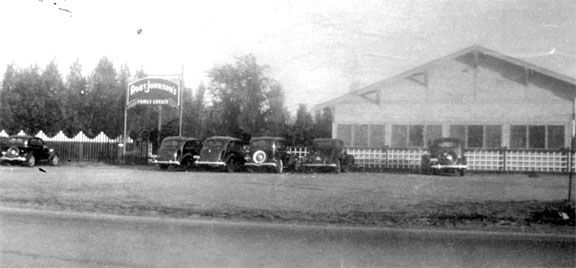
1174 Arcade Street, St. Paul. Can’t read these notes very well, but here goes: Bands included:
- Coachmen
- Peppercorns
“Patrons went from respectable to repulsive.” Corner is now a Walgreen’s.
East Hennepin.
This building at 1500 E. 78th Street in Richfield was first advertised as office space in 1969.
RODNEY’S AND MINE
The January-March 20, 1971, issue of Connie’s Insider reported that a new rock club by that name would be opening very soon on Highway 494 in Richfield (and felt the need to explain that Richfield was a suburb of Minneapolis.)
Rodney was Rodney Smith, who owned and operated the club with his wife.
Again, the Insider: “Jimmy Lawrence’s new band will open the club musically speaking.” Denny Johnson tells us that this new band was called Carrion:
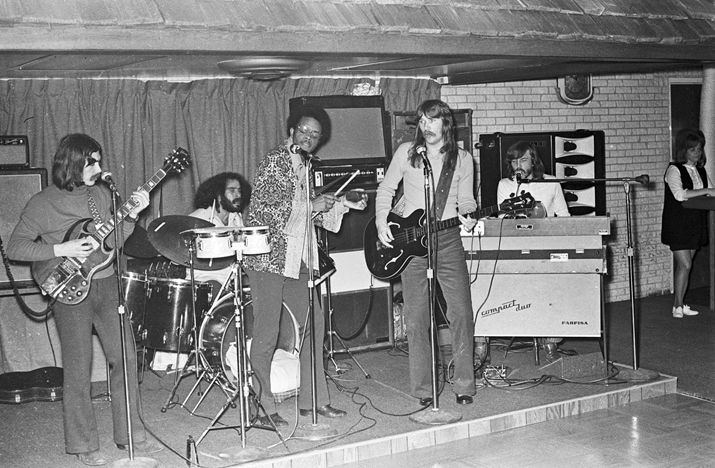
May 1971 Photo copyright Mike Barich, St. Paul
The club placed two ads for staff in May 1971, warning applicants that they would be working in a “loud, overcrowded, swinging saloon.”
Perhaps they were overconfident; no more ads were found until May 1972, when another couple of ads described the place as “small but growing.”
Someone on Facebook remembered it being there into 1973.
LOS BRAVOS MEXICAN RESTAURANT
Ads for waitresses for this new restaurant began to appear in March 1973. The restaurant lasted until at least February 1979.
GROUND ROUND
Ads for wait staff appeared for the Richfield Ground Round in late July 1980. Ground Round was a chain – at the time there were also locations in Fridley (which had music), Brooklyn Center, Roseville, West St. Paul, and St. Paul.
Roger’s Cafe was on Nicollet Ave. in the 1920s and featured pianists Arnold Frank’s Band.
ROGERS
STAN’S PLACE
South 4th Street, Minneapolis. Early entertainment by Hal Keller’s Band.
The Roller Garden, located at 5622 West Lake Street in St. Louis Park, started life in 1930 as an arena built for horse shows. In mid-1943, Arthur Eaton installed a wooden floor and added roller skating to the offerings at the arena. In 1946, the facility was called the Pastime Arena Roller Rink – “One of the world’s largest rinks” – Music by Tommy Arsenault. Eaton sold the arena in 1957. The 1964 directory referred to it as just the Roller Garden, and the facility became a part time rock ‘n’ roll dance to venue. In 1969 the building was purchased by current owner, Bill Sahly.
1123 Excelsior Blvd., Hopkins. Dancing to the “famous Red Jackets” on Friday nights. Just what the Doctor ordered! Ad below from 1954.
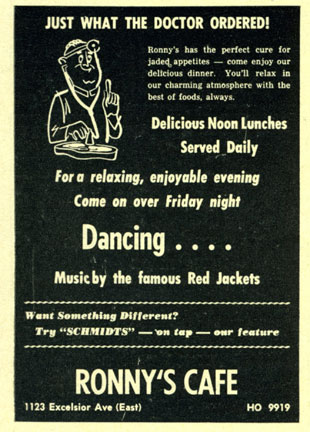
The Rose Bowl, on N. Snelling in St Paul, had a live music room, at least in 1969.
Minneapolis
Minneapolis
3011 First Ave. So. (at Lake Street) was the site of an NAACP Coronation Ball in 1941. In 1944 the managers were Charles Clifton Jackson and Robert “Bobby” Marshall, Sr. and they sponsored a series of dances featuring Larry Griffin and his Rhythmaires. The Royal Arcanum was a sort of fraternal organization that provided life insurance to its members. It was associated with the Knights of Honor, which went bankrupt in 1916.
The Royal Court at Knollwood Shopping Center offered live entertainment. June 1969: Rock in the Dungeon Bar, Tommy Francis Duo in the High Court Bar. A duo called the Quasi Kinship performed there in August 1969. It was down from Powers and next to Aqualand. When it closed it was replaced by a club called Renaissance (circa 1977), which lasted almost a year with its country rock – bands like Daisy Dillman and Whiskey River.
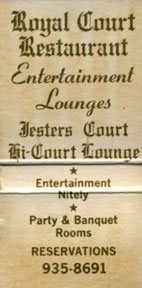
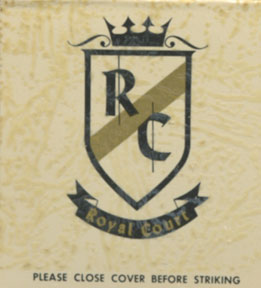
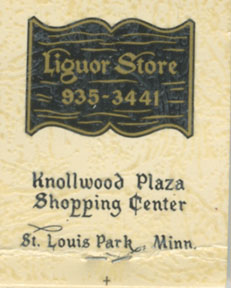
This page concerns two dining and dancing establishments located at 503 1/2 Hennepin Ave., in the Hale Block at 5th and Hennepin in Downtown Minneapolis.
For the history of the Hale Block, which contained two other addresses of entertainment, click here.
THE NEW PEKING CAFE
The New Peking Café opened on September 27, 1919, on the entire second and third floor of the Hale Block, where apartments. The manager had the decidedly un-Chinese name of Jens Founesbeck. Although Prohibition was at hand, it was a dining and dancing place bar none.
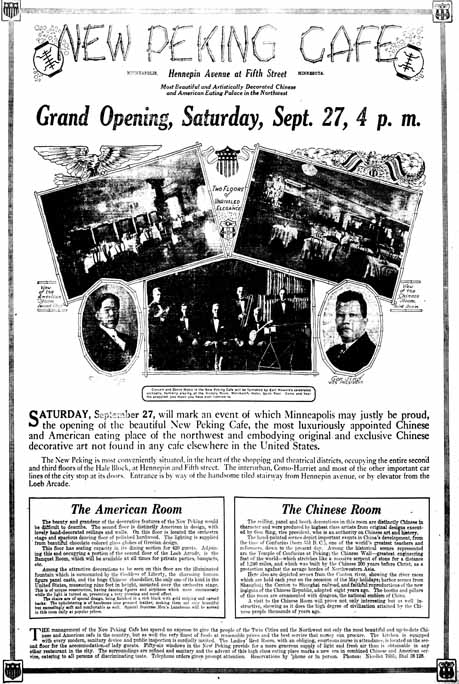
Minneapolis Tribune, September 27, 1919
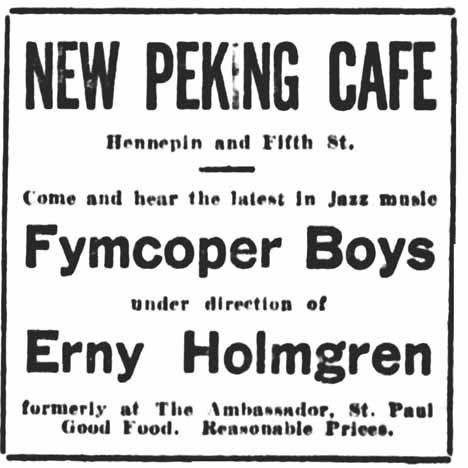
Minneapolis Tribune, April 27, 1920
A devastating fire on June 29, 1921, didn’t stop them for long, and the next ad was up soon with an Amateur night, although for a long time no actual address is given until May 1922. In August 1922 it was closed for two days and a night when two guys with Irish names got into a fight with two detectives and were arrested for being intoxicated. Their girls were released to their mothers. After a hard fight, the place got its soft drink license in November 1922.
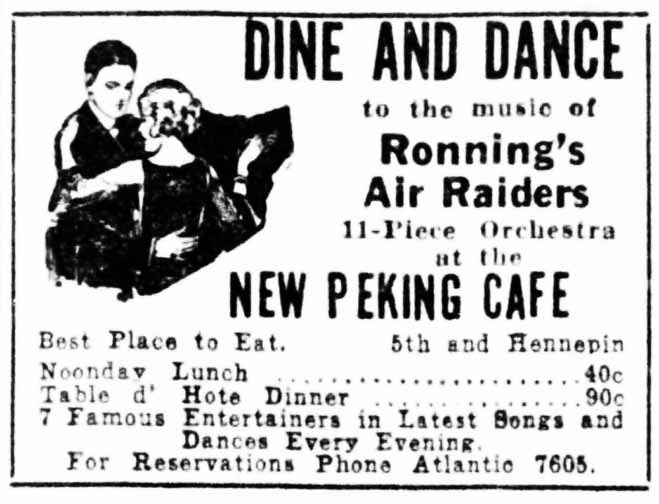
Minneapolis Tribune, February 13, 1924
But on May 9, 1924, it was raided by police and closed for selling liquor, selling ginger ale at exorbitant prices, and permitting people to bring in their own booze. Just two days later, on May 11, 1924, there was another fire, and in June 1924 they lost their dance hall permit – it was speculated that there was a crack down on “chop suey places.” The place disappears until January 1944 when a place with the same name shows up at 918 Hennepin Ave.
ROYAL GARDEN CAFE
The Royal Garden Cafe, 503 Hennepin Ave., opened for business on August 30, 1924. There was some opposition to granting it a dance hall license, since it was the New Peking by another name, but it got its license in August/September 1924.
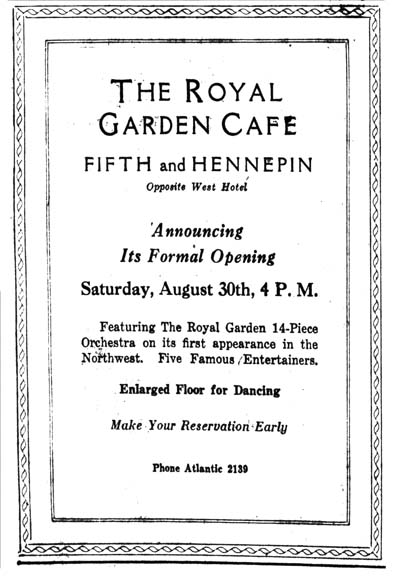
Minneapolis Tribune
It suffered smoke damage from a fire in October 1924.
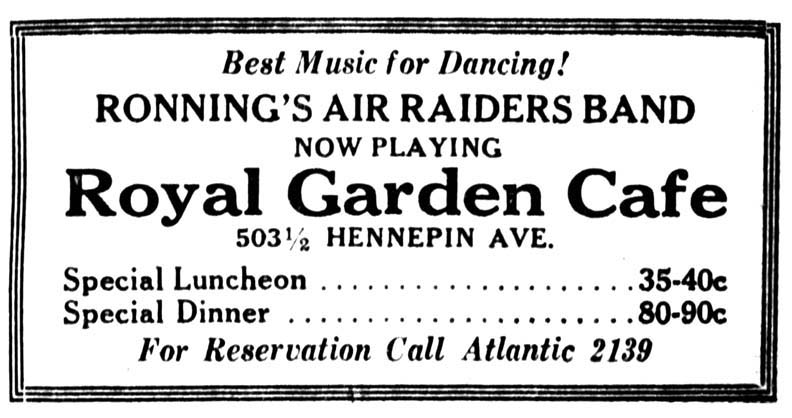
Minneapolis Daily Star, May 5, 1925
An auction/notice of bankruptcy sale for the Royal Garden was published in the Minneapolis Tribune on February 12, 1926. The address given was 503 1/2 Hennepin Ave., Second Floor.
Please see the Golden Pheasant.
FILIPPO’S
Filippo Rusciano received confectionery, soft drink, and pool table permits at 702 Buchanan Street NE, Minneapolis, in April 1932. “Confectioneries” were often candy stores that were either waiting out the end of Prohibition, or serving hooch in the basement. His food permit came in July 1933. And he got his on and off sale beer permit in April 1934.
This establishment operated as Filippo’s, and was operated by Filippo and Josephine Rusciano. On February 27, 1950, Josephine was fined $100 and the bar’s license was suspended for ten days for selling whiskey when the bar only had a beer license. The whiskey was found in two root beer bottles behind the bar. (Minneapolis Tribune, February 28, 1950)
Filippo died in August 1975 at the age of 89.
RUSCIANO’S FOOD MARKET
In 1944 Frank and Corona Rusciano opened their own grocery store at 1301 Summer Street NE. Frank was the son of Filippo. In 1946, they started making frozen pizzas.
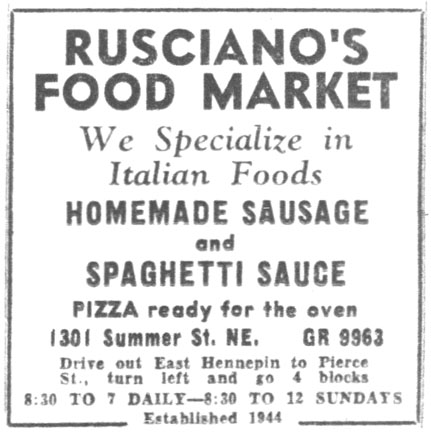
October 27, 1950
206 South 4th Street
In December 1952, the Ruscianos opened a second grocery store downtown at 206 South 4th Street. Although it was touted as a second location, it turned out to be a move to the 4th Street location.
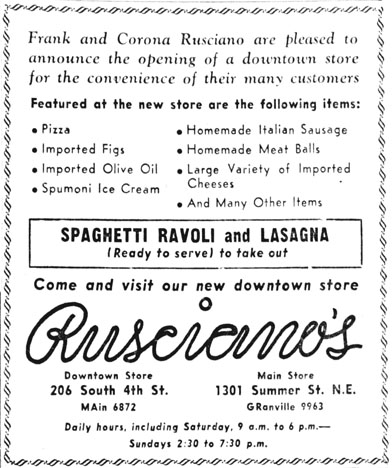
December 18, 1952
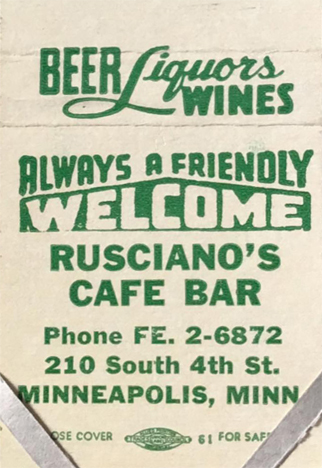
From the collection of Mark Youngblood
In January 1953, Will Jones reported that the Ruscianos opened a lunchroom behind the grocery store because customers were disappointed they couldn’t “gobble on the premises.” (Minneapolis Tribune, January 20, 1953). Business from the nearby courthouse forced them to expand, and soon the sideline to the deli became a full-blown restaurant. By April 1954 the restaurant was open until 2 am on Fridays and Saturdays.
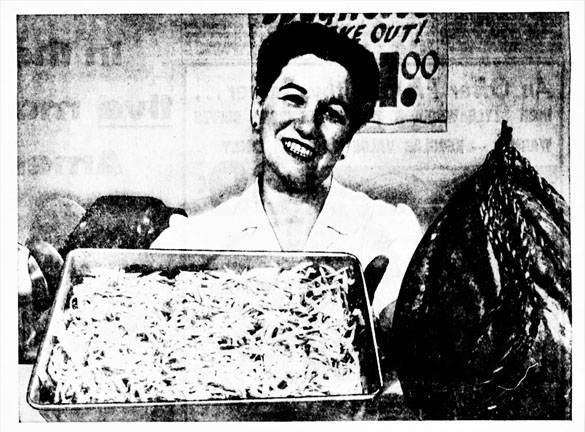
Corona Rusciano, Minneapolis Star, January 31, 1955
In February 1958, the liquor license of the Covered Wagon was transferred to Rusciano’s, so they could finally serve wine with their Italian meals. The Covered Wagon had gone out of business to make way for the new Hennepin County Government Center.
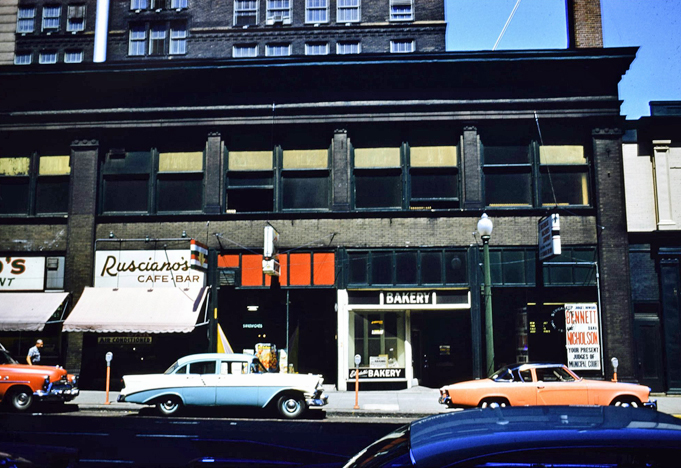
Rusciano’s, 1959. Photo courtesy Hennepin County Library
328 South 3rd Street
In November 1959, the fate of the Covered Wagon was met by Rusciano’s as well, as its building was one of the sites cleared for the Gateway Redevelopment project. It was demolished in September 1961.
After months of looking for a new location, Frank and Corona Rusciano bought the former Commerce Club Restaurant and Bar, and the new name was originally going to be Rusciano’s Commerce Club. The owners of the Commerce Club were Omar and Ann Vance. (Minneapolis Star, May 13, 1960)
The 3rd Street building dates to 1885, according to the permit card. (In city records this corner property is listed as 246-50 4th Ave. So.) It served as everything from a tailor shop, blacksmith shop, brass foundry, and a hotel from at least 1907 to 1926. In April 1934 there is the first indication of a cafe, and everything that follows appears to be consistent with a restaurant.
The last meal at the 4th Street site was served at midnight, Friday June 10, 1960, and the new site opened on Monday, June 13, 1960. A February 1961 blurb in Select magazine describes the restaurant:
A new location for an old favorite where Italian food and wine is served. New decorations are planned but even now wine bottles hang from walls, candles twinkle and oregano scents the air. American food too. Wide variety of Chianti wines.
Matchbooks below from the Collection of Mark Youngblood
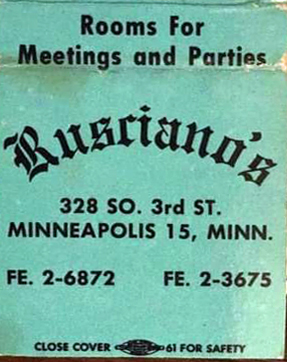
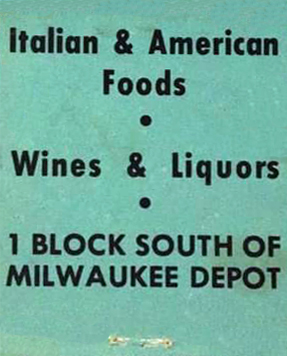
Robert T. Smith at the Tribune described Frank as a world-class insult artist, and he often recorded their exchanges in his column in the Tribune.
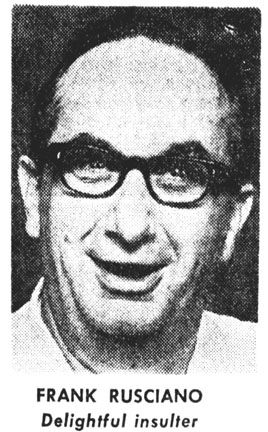
Minneapolis Tribune, August 13, 1969
An interesting item appears in September 1974, when a group of “welfare mothers” who felt spied on by their case workers decided to retaliate by doing the same and do some surveillance themselves. They charged that many workers “drank their lunch” and returned to work “in various stages of intoxication.” Rusciano’s was one of the five bars listed, no doubt because of its proximity to the government center. (Minneapolis Tribune, September 28, 1974)
MUSIC AT RUSCIANO’S
Food was always the emphasis at Rusciano’s, and the newspapers often printed recipes from the restaurant. A February 1961 blurb in Select magazine indicates that there was entertainment, but doesn’t elaborate.
There were few ads, although in the mid-sixties, ads for their smorgasbord started to crop up. A New Year’s Eve party in 1964 mentioned a live combo, but not the name of the group. Same in 1965: music by a “well known combo.”
Robert T. Smith reported that in 1972, Frank and Corona turned the restaurant over to their son, Phil, who tried promotions such as lingerie shows and dance band, “but it didn’t work out well enough.” (Minneapolis Tribune, April 21, 1978) Scotty McFarlane was listed as the performer from November 1977 to January 1978.
THE END OF RUSCIANO’S
The restaurant’s last day was April 29, 1978.
Frank died February 2, 1981.
Corona died on December 18, 1985, at the age of 70.
700 W. 66th Street in Richfield, owned by Jim Rush in 1972. Now vacant land.
An ad described this as three miles west of Crystal on Bass Lake Road; recently it was described as being in Plymouth.
In 1963 it had polka bands, the Country Cousins, Kris Kober, and Bob Mastel. In 1967 it was only open to teens on Fridays, but an ad from that March indicates that there was no rock ‘n’ roll there.
Ryan’s Bass Lake Pavilion/Ballroom was described in ads as being 4 1/2 miles NW of Robbinsdale on County Road 10.
Ads I have on file range from 1950 to 1974, although I haven’t yet done a search on the Star Tribune database. Here is just one.
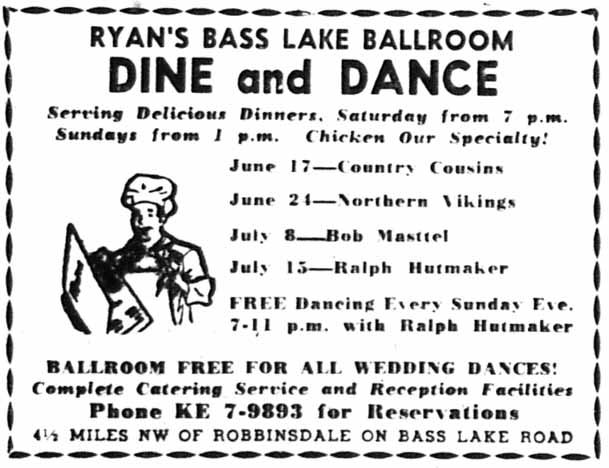
North Hennepin Post, 1961
The S Cafe was in Clear Springs, which is out Minnetonka way; I think south of Highways 7 and 101.
In October 1933 they offered FREE DANCING every Saturday and Sunday nights with Ed’s Concertina Orchestra, and Wednesday nights with Dick Stodola’s Red Jackets.
The Saddle Bar was located at 415 Hennepin Ave. It was basically a strip club that employed jazz groups.
THE BUILDING
The 413-415 Hennepin Ave. building predates 1888, and has had a restaurant since at least 1893. It had a lot of alterations along the way, and seems to have had a lot of fires through the years. Before it was the Saddle Bar, it was a store building, selling used furniture, cigars, and off-sale liquor.
The two story building is wedged between the Andrews Hotel (below on the left), and the Lumber Exchange building at the corner of Fifth and Hennepin.
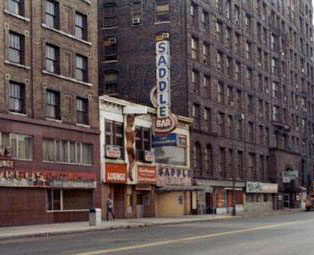
THE RED FEATHER
The Saddle Bar started up in 1949 with the liquor license of the Red Feather Cafe, which had been at 18 South 4th Street at Hennepin Ave.
In 1947 Carl A. Rees transferred the liquor license of the Red Feather to brothers and former U of M football players, Allen “Tuck” and Alvin J. “Nip” Teeter. In August 1949, the licensee was Mrs. Allen Teeter, Tuck’s wife.
In November 1949, Mrs. Teeter asked to move her license to 415 Hennepin Ave. to start a bar with no food. The name would tentatively be called the 415 Bar. (Minneapolis Tribune, November 10, 1949)
THE SADDLE BAR
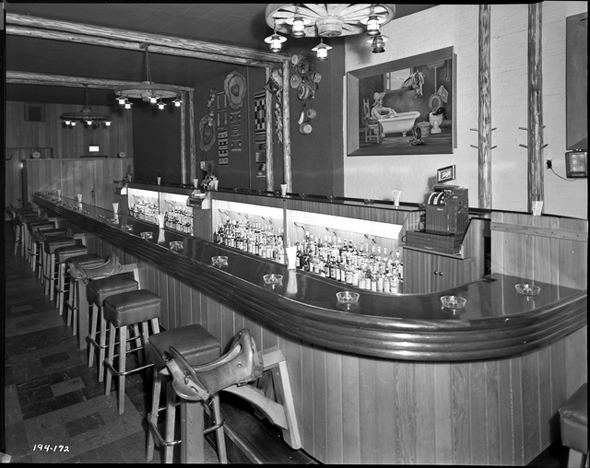
Saddle bar with saddle barstool, April 4, 1950. Photo courtesy Minnesota Historical Society
In January 1952, the license was transferred to A. Edward “Eddie” Holman.
The bar featured unique saddle-shaped barstools, which had to be removed when the City decided to enforce an old ordinance prohibiting unaccompanied women from sitting at bars. Many places had to reconfigure their whole layout to take out parts of bars and add booths for the ladies. (Minneapolis Tribune, October 13, 1953)
But Eddie got in trouble with his taxes, and in June of 1954 the license was transferred to Oscar Rubinsky, who had previously been the manager of Curly’s Café.
THE HIDEAWAY ROOM
The Hideaway Room sounds intriguing – perhaps just a piano bar?
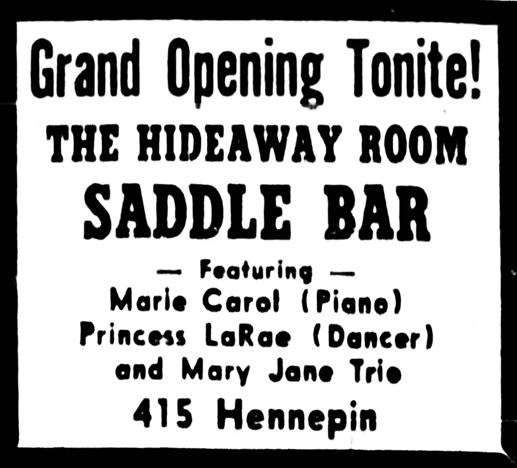
Minneapolis Star, December 17, 1954
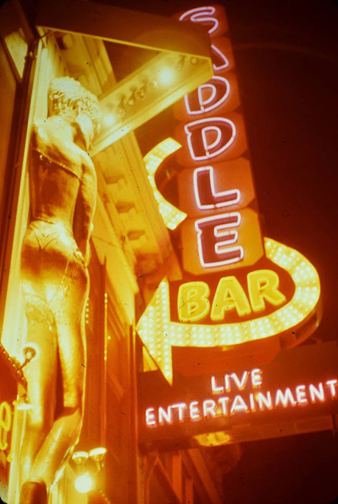
1967 photo courtesy Hennepin County Library

Minneapolis Tribune, December 31, 1968
The building, which also held the Copper Squirrel, was owned by Harry Smull, who also owned the Copper Squirrel next door. Smull died in 1972.
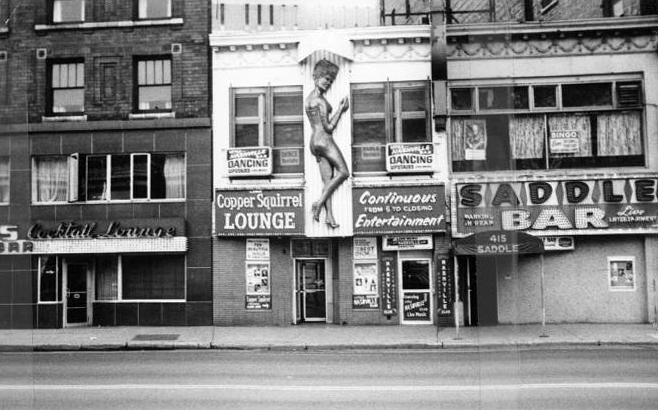
The Andrews Hotel, Copper Squirrel, and Saddle Bar, 1970. Photo courtesy Hennepin County Library
From 1959 to 1975, the business was operated by William R. Engfer, Smull’s Son in Law. A co-owner was Peter W. Giedras
On October 10, 1975, the liquor license was transferred to Howie’s Bar.
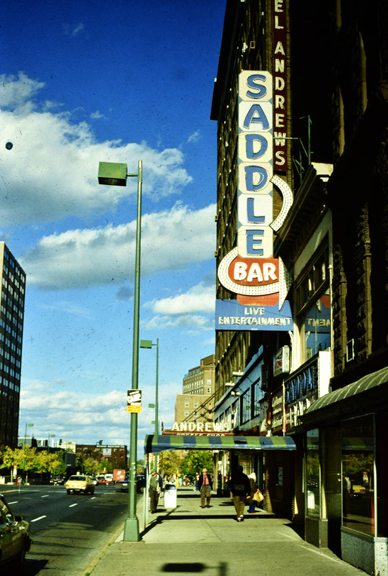
Saddle Bar sign, November 10, 1978. Photo courtesy Hennepin County Library
On January 15, 1984, the building was demolished along with the adjacent Andrews Hotel.
This building was located at 2705 Highway 55 at Lexington in Mendota Heights, 2.5 miles south of the Mendota Bridge. It hosted two teen clubs: the Safari Club and Bobby’s.
THE SAFARI CLUB
The Safari Club opened to teenagers in 1963, Thursday to Saturday nights.
Irv Letofsky, subbing for Will Jones in the Trib on October 25, 1963, told of receiving a flier addressed as “Dear Teen-ager” which had been sent to 3,700 “highly moral” teenagers in the Twin Cities area, and, should there be enough response, the club would be opened in a former appliance store on November 15. The decor would be Polynesian and the club would feature exotic soft drinks. Charter membership was $10/year; regular membership $15/year. Guest admission was $1.25.
Another article described it as the Upper Midwest’s first teen-age night club, “a members-only key club,” open to kids from 16 through 20. Entertainment was to include folk singers, jazz combos, surfing music, and comedians. A hootenanny was tentatively planned for every Sunday afternoon. The Saturday night dress code was to be semi-formal. Much was made of the code of conduct, including no alcohol; detectives would be on duty.
The club was to be owned by a corporation, whose principal stockholders were Bobby Mecay, a University of Minnesota student and ice skater; Charles Mecay; Richard H. Murray; and David Eckstrand, a former instructor at St. Thomas Academy who would manage the club.
In January 1964 Will Jones reported that an ad in the Minnesota Daily described it as “A Plush Polynesian Pad” that featured folk music, but as he was over 21 he couldn’t investigate. The ad warned in large type, “IF YOU ARE 21 STAY OUT.”
Facebook folk remember that teargas was let loose inside a couple of times, and that kids had to escape through the back door to get some air?
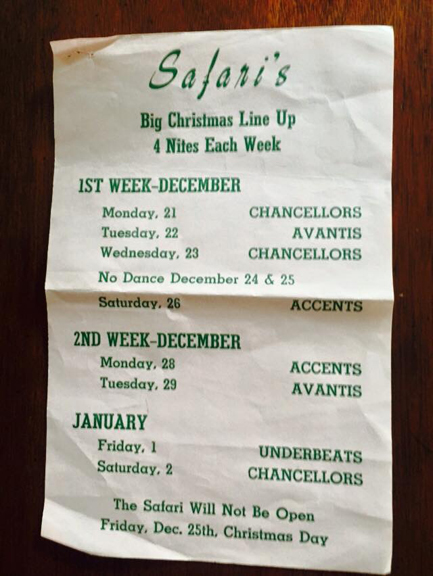
BOBBY’S
Prior to about 1965 the Safari was renamed Bobby’s Teen Club, owned by Bobby Mecay. Mecay was in the paper often for his skating up until January 1966. Bobby’s was open to teens ages 16-20 only and featured movies and a slot car track.
In 1966 Tom Castaneda was General Manager. There was music on two floors and variety in the back room.
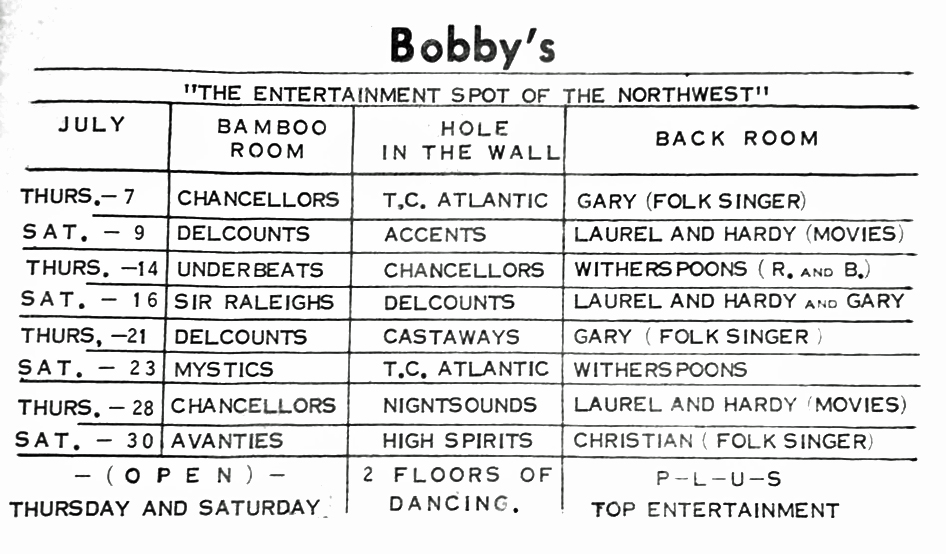
Schedule courtesy Rick Beresford
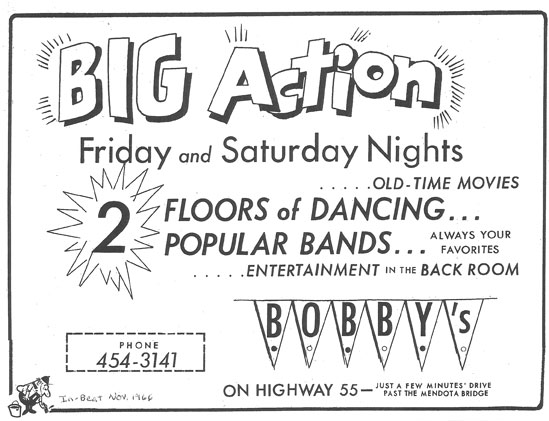
Image from In-Beat Magazine, November 1966
In 1967 it was only open on Fridays and Saturdays. In April 1967 the Underbeats recorded 43 songs at Bobby’s for Metrobeat Records.
Bobby’s burned down in November 1967. Bobby Mecay became a real estate executive.
Please See More Down Stairs.
The Sandpiper Supper Club was located at 4785 Hodgson Road (Highway 49) in Shoreview, north of Highway 694.
HALFWAY HOUSE
Mary Hilfiker, who edited “Shoreview Reflections,” a history of the community, said that when truck farmers from Anoka were bringing their goods to market in St. Paul by horse and wagon, they would stop for the night at an inn at the intersection there called the Halfway House. It was unclear which sector of the intersection the Inn was located.
SHOREVIEW TAVERN
The first venue that comes up under the address is the Shoreview Tavern, operated by Michael J. Dougher, who received his liquor license by the Shoreview Village Council on November 28, 1961.
In February 1965, two people were listed as living at this address. There was apparently a detached house on the property.
THE SANDPIPER SUPPER CLUB
The Sandpiper held its Grand Opening on November 11 and 12, 1966. (Meetings were held at the Sandpiper Restaurant back to November 1, 1966.) The Mel Calvert Combo entertained.
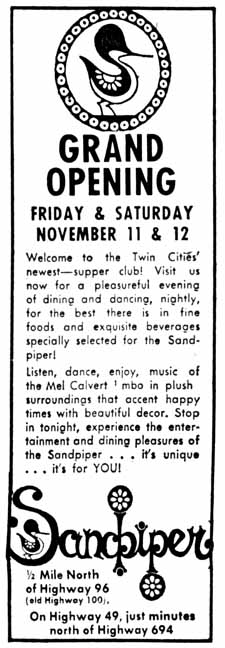
Minneapolis Tribune, November 11, 1966
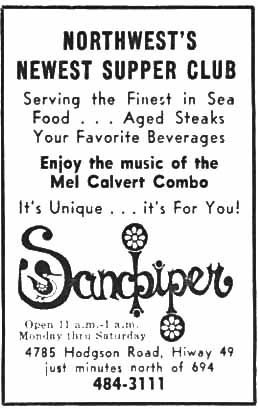
American Jewish World, December 30, 1966
In 1967 you could dance to Cindy and the Chordsmen, Wednesday-Saturday.
In February 1968, there were several liens on the property, and there were articles about it being sold, but one has to assume that it was – no follow-up was found.
That same month, February 1968, saw the introduction of the Visconti Show Band, from the Sunny Shores of Italy. This first engagement lasted until August 1968. They would return in April 1969 – please see the ad below.
In October 1968, Kay Nygaard took the stage at the Sandpiper. Not sure what “Set your course to the BRIG Rock to the seinging sounds of the BMI” might mean.
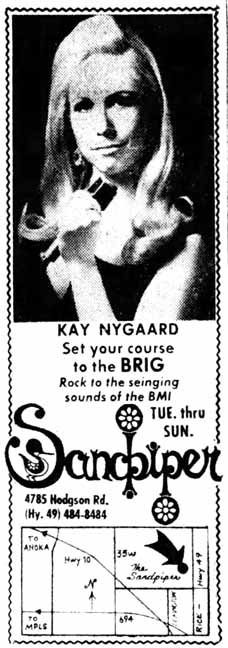
Minneapolis Tribune, October 9, 1968
CLIPPER SHIP AT THE SANDPIPER
Here is the Visconti Show Band back again. This time they are launching the clipper ship “Piper-on-the-Rocks on May 2, 1969. Bill Robertson, a Glen Campbell doppelganger, performed in the ship’s hold.
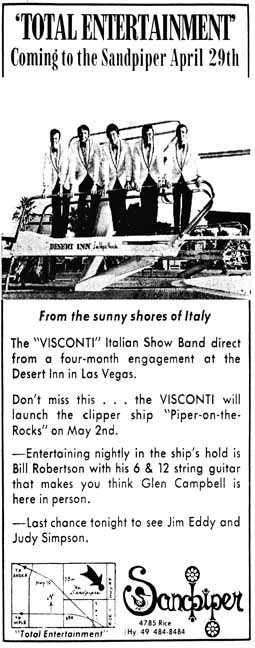
Minneapolis Tribune, April 27, 1969
An ad dated September 7, 1969, announced that “Total Entertainment returns to the fabulous Sandpiper Supper Club,” starting with a musical comedy group called the Cameron Company.
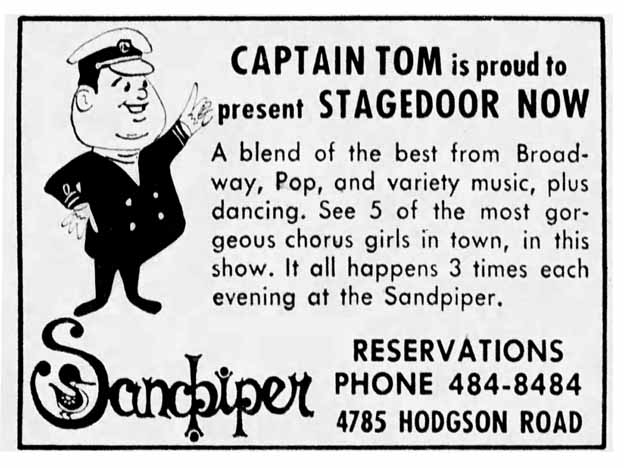
Minneapolis Tribune, September 30, 1969
In 1976 the Manager was Joe Daszkiewicz. One article indicated that there was an outdoor boxing ring.
There was a dearth of advertising, but the ad below indicates that the Royal Strings had been entertaining since about 1973. Not sure what a “Cathedral Atmosphere” would be.
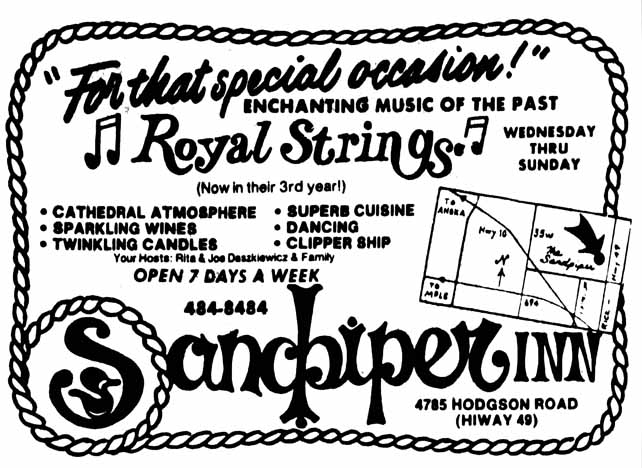
Minneapolis Star, February 17, 1976
ABANDON SHIP
In June 1977, the Sandpiper was put up for sale by the U.S. Small Business Administration in a sealed bid auction. My guess is that the owner forfeited on an SBA loan and it went into the agency’s inventory to be sold. The restaurant was abandoned and “a total mess,” according to historian Mary Hilfiker.
KOZLAK’S ROYAL OAK RESTAURANT
Ruth and Jack Kozlak bought the restaurant a little more than a week after Jack spotted the auction notice in a Sunday newspaper. Jack’s parents were Joseph and Gertrude Kozlak, who founded Jax Café in Minneapolis in 1943. Their three sons later went into the business and built Jax into one of the state’s largest free-standing restaurants.
Kozlak’s opened in 1977 and became known for its New Orleans Jazz Brunch.
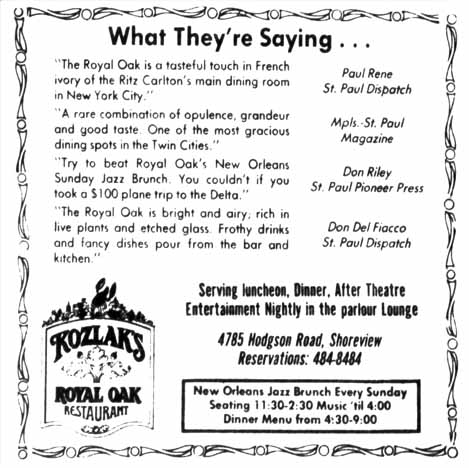
Minneapolis Star, August 16, 1978
THE END
Jack Kozlak died in 2012, and the Kozlak’s building and land were put into a trust as part of the estate. Kozlak’s daughter Lynn and her husband Mark Satt kept the business, but it was always part of the plan to eventually sell the property. Kozlak’s closed on March 15, 2014.
The following are excerpts from an article from the Minneapolis Star Tribune written by Jim Anderson, published on March 4, 2014.
The Kozlak’s property has been sold, and the restaurant at the busy corner of Hodgson Road and Tanglewood Drive in Shoreview will be demolished to make way for a 77-unit senior residential cooperative. Construction is planned to start this summer.
Lynn Satt said the couple have been searching for the past several months for a new restaurant to buy or operate, and would like to keep as many employees, many of whom have been at Kozlak’s for years, on staff as possible.
“We’d like to stay on this side of town; it could even be Stillwater, Vadnais Heights. There’s just not a lot available. It’s been difficult,” said Satt, who along with her husband is the third generation of restaurateurs in the Kozlak family. “If there was a country club, we could walk in and run their catering operation. Our staff is so good at weddings.”
The next couple of weeks will be savored as a farewell celebration, with the Jimtones, Mark Satt’s rock band, playing a final time on Saturday night.
Mary Hilfiker said the restaurant will definitely be missed. It has been both a place for special occasions and for a core of local regulars who appreciated the kind of elegant dining experience that is becoming more rare.
“It was really the only place in the northern suburbs for that kind of thing,” Hilfiker said. Longtime staff and customers know one another’s names, and the garden, patio and mature oak trees made it a relaxed setting.
Terry Schwerm, Shoreview’s city manager, said the city has been working with the Satts to relocate the restaurant in Shoreview.
In the meantime, Schwerm said converting the old restaurant into new housing for seniors will put the property to good use. The purchase price for the site, which includes an adjoining lot with a single-family home, was $1.3 million, city records show.
Schwerm said creating new housing for seniors will help fill a growing need in the city. The United Properties development, located near the city’s community center and other amenities, is geared for younger seniors who are still active and don’t need care.
As for the property’s majestic oaks, 13 of the 18 mature trees will be spared, according to the redevelopment plans. Dozens of new trees will be added, as well.
Sandy’s Tavern is located at 6612 Penn Ave. So. in Richfield.
Sandy’s Tavern’s website says that it was established in 1933, which was right after Prohibition.
According to the county’s tax website, the building was built in 1934.
In March 1934, an ad was run, selling furniture from a large home from that address.
PENN AVE. INN
An item dated January 8, 1937, said that the newly-formed Rural Hennepin Tavern Association would meet at the Penn Ave. Inn at this address.
CHAPMAN’S TAVERN
This early ad indicates that it was next Chapman’s Tavern. Harry Chapman was the operator on September 17, 1937, and it was Chapman’s Tavern on December 31, 1939. Music by Chapman’s Gloom Chasers!
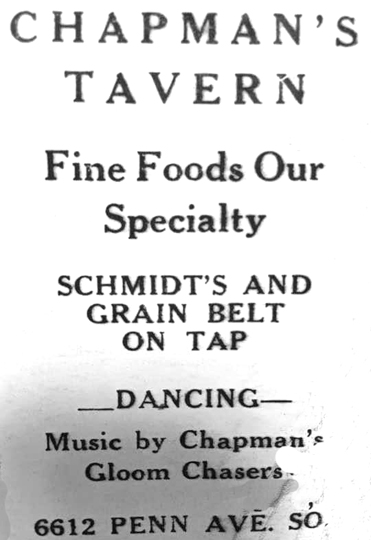
Ad courtesy Richfield Historical Society, via Terry Ahlstrom
Not sure if this is the right one, but there is a Harry Chapman who lived at 66th and Oliver Ave. So. who died in September 1940.
SANDY’S TAVERN
Sandy was A.B. “Sandy” Crans, who operated the tavern from 1941 to 1948 (presumed) – he died in August 1948.
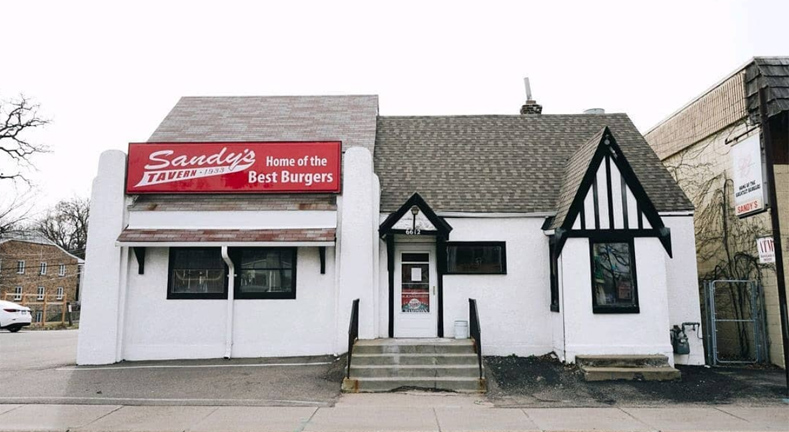
Image from Sandy’s website
Sandy’s advertised dancing every Saturday night in 1944.
Ads for help can be found from 1953.
Sandy’s closed in September 2019 in order for manager Matty O’Reilly to make some cosmetic improvements to the 80 year old burger bar, reported Sharyn Jackson of the Minneapolis Star Tribune. It reopened at the end of November 2019, now taking credit cards. (December 5, 2019)
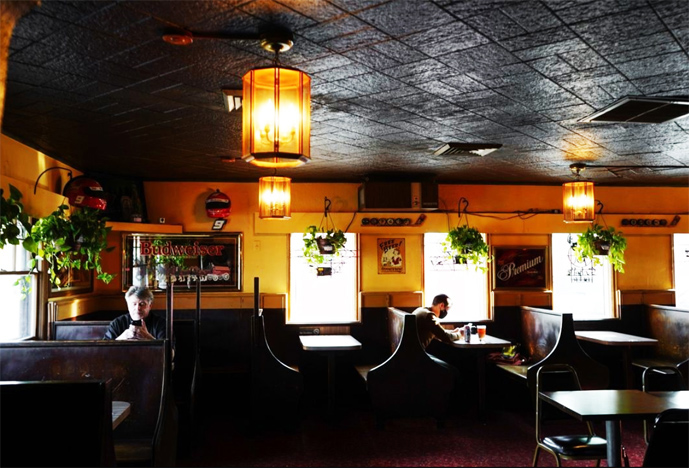
Photo from Sandy’s website
Please see the Iron Horse.
1723 Fourth Ave. So. The Family Tavern – Dancing – Fun
Schiek’s Cafe had a long history in Minneapolis.
FRED SCHIEK
Berliner Beer Halle: 122 Hennepin Ave.: 1887
Schiek’s was started by and named for Frederick Schiek, who was born in Sinshein, Baden Germany in about 1836. He emigrated to New York City, where he lived from 1852 to 1858, and then to a farm outside of Lansing, Iowa, in 1859. In 1862 to 1887 he was a merchant in Lansing, and then to Minneapolis in 1887.
His obituary said that in his early business career he managed the old Berliner Beer Hall at 122 Hennepin Ave., which was across the street from City Hall and owned by Louis Brandt. Permit cards show that this building was extant in 1887, and was a saloon in 1891. It was also a hotel and a mission. This building was recently replaced by an apartment building in 2017.
An article about a court case in the Minneapolis Tribune dated March 11, 1893, indicates that Schiek operated a saloon at the corner of Washington and First Avenues, and may have done so for at least five years. Thus, the year 1887 would seem to be in order. He was in a lawsuit against Brandt about renewing a five year lease.
It was still the Berliner Halle Saloon in October 1901. Brandt was running it.
Importer: 49 Washington Ave. So.: 1887 to 1894
Schiek also had a wholesale liquor house 49 Washington Ave. So., apparently while he was working at the Berliner. The first hit in the Star/Tribune database for Frederick Schiek was on December 28, 1888, when he was listed as a merchant in a list of other merchants. Ads placed in the Tribune in April 1890 call Schiek an importer of fine whiskeys and liquors, running his business from 49 Washington Ave. So. This does not appear to be a restaurant or a cafe, however. But the start of the Schiek’s name is often counted from this date.
THE BIRTH OF SCHIEK’S
45 and 47 Third Street So.: 1894 to 1961
Fred Schiek started his business at this location on June 30, 1894. Schiek bought the once famous Frank Shaw’s Columbia poolrooms. In 1883 there was a Frank Shaw who was a gambler who got in trouble for running a disorderly house, and an article from 1887 mentions that he and a partner ran a pool room. The building goes back to before 1884.
Schiek tore the building down to its foundation and built everything up out of mahogany. The bar was 40 feet long, consisting of five arches resting on six fluted columns with carved caps above. Even the cigar case and lighter were described in florid detail. There was a lunch counter with a dumbwaiter that ran downstairs where all the cooking was done. Ferns and flowers could be placed in against the wall. Five banquet rooms were available, in a modern style that could be combined into one big room. Schiek had a private office and a wine showroom, and a cold room in the basement to keep his stock. (Minneapolis Tribune, Saturday, June 30, 1894)
OLDEST CAFE
Schiek’s Cafe was often said to be the oldest restaurant in Minneapolis when it closed in 1971.
There were two years in contention for when it opened.
When it closed in 1971 the news article said it had been in business for 109 years, making the opening year 1862. This guess was apparently based on wine labels found in the basement bearing Fred Schiek’s name (as importer) and the 1862 date. The chronology says that Fred was in Iowa in 1862, so the labels could have come from there. Or it may have been aged wine?
But according to Minnesota Eats Out and the ad below from the program of the Norwegian Sangerfest (songfest), held in 1930, the year would be 1887.
Given the fact that Schiek was just the manager of the Berliner and it did not change its name, I think it would be fair to say that the actual Schiek’s started when Fred Schiek put his name on his own cafe in 1894, making the total run 77 years.
A one-line ad on October 6, 1894, says “Try a Lobster – A la Francaise, at the end of Fred Schiek Co.’s Shell Fish Buffet, 45 and 47 Third Street South.”
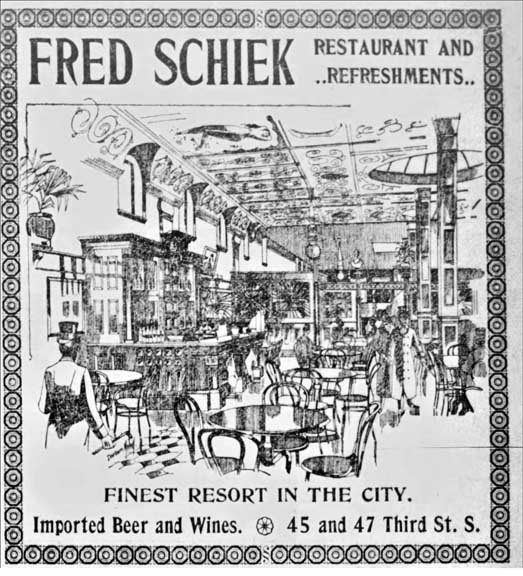
Minneapolis Tribune, March 25, 1896
THE DEATH OF FRED SCHIEK
Fred Schiek died on April 8, 1904, after a protracted illness. Much was made of his desire to die on a Friday, and that he did. Operation of the restaurant went to his son, Louis, and his son-in-law, J.H. Heiser.
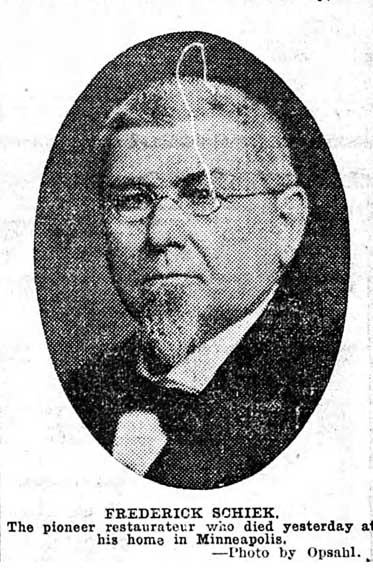
Frederick Schiek, Minneapolis Journal, April 1904
Elegant or no, Schiek’s was still a Saloon, no unaccompanied ladies welcome, no ladies approving.
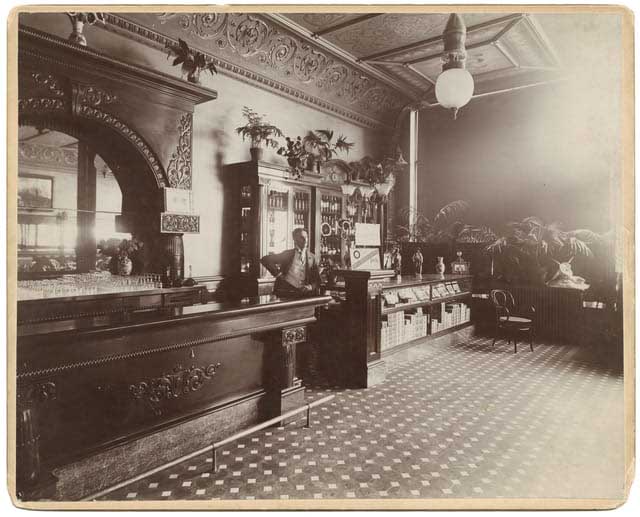
1905 Photo courtesy Minnesota Historical Society
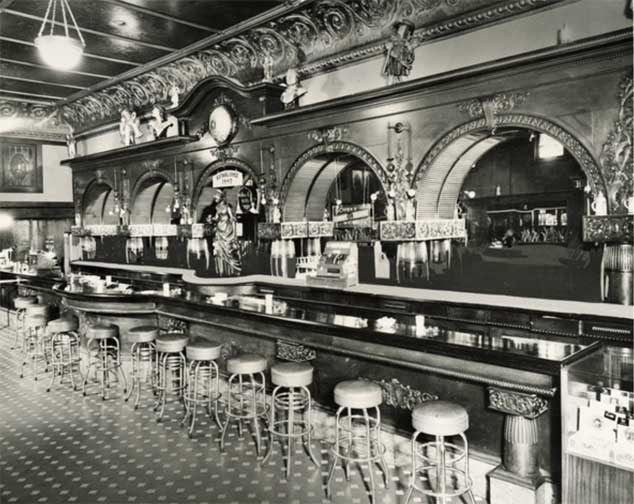
Schiek’s Bar – No Date. Photo courtesy Minnesota Historical Society
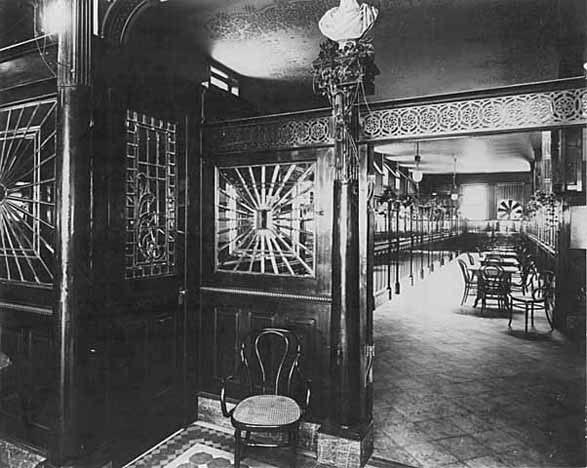
Inside Schiek’s – Photo courtesy Minnesota Historical Society
On July 22, 1908, the Tribune ran a story about prolific drinking Downtown, with flagrant violations of the law. Minneapolis may have been wet or dry during this pre-Prohibition year, but the drinking was certainly going on after closing time. Schiek’s was one of the places visited by the reporter, who cited drinking with no food served. The bartender closed the door at 2 am, but people could still get in through the back door. There were reportedly hundreds there – and this all happened on Wednesday, July 15, 1908.
In December 1911, Schiek’s began an advertising campaign, placed by the Fred Schiek Co. in large print.
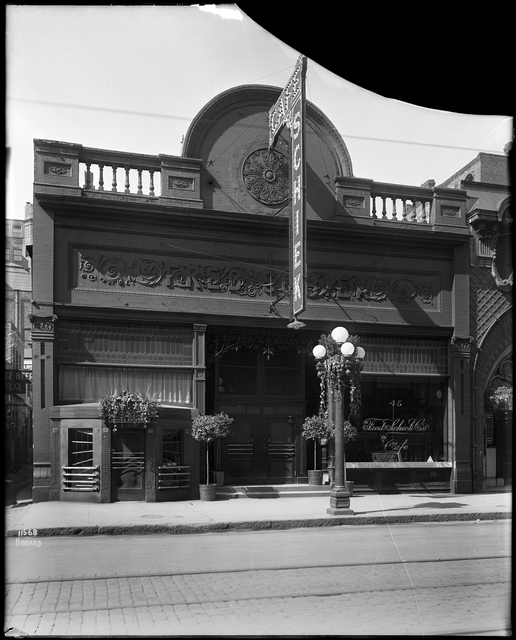
1912 Photo courtesy Minnesota Historical Society
PROHIBITION
Although 1930 was a pure Prohibition year, the ad above promotes light and dark lager, which turns out to be a process to make beer, or in this case, near-beer, no doubt.
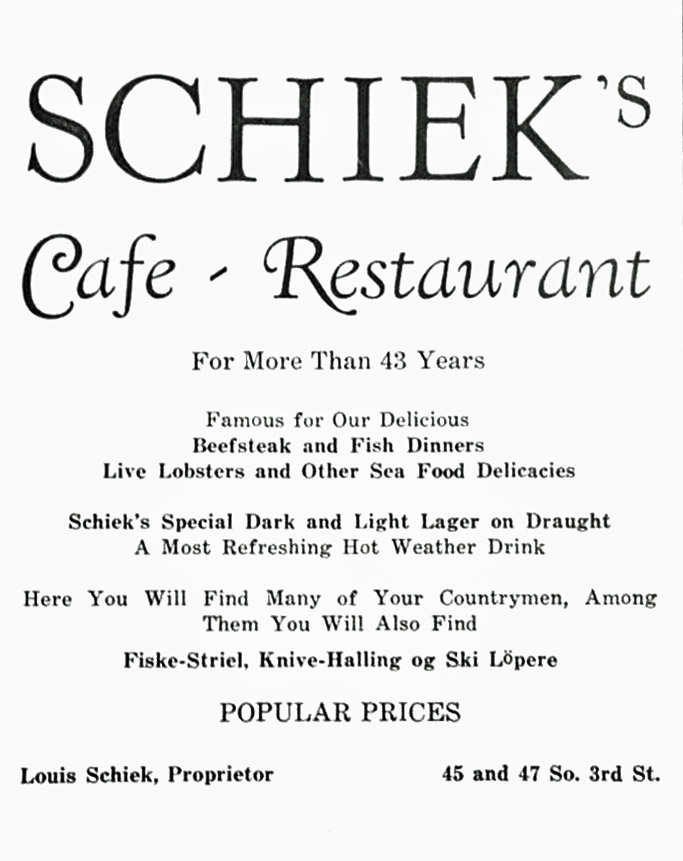
1930 Ad Courtesy Mark Youngblood
THE END OF PROHIBITION
Beer became categorized as “non-intoxicating” on April 7, 1933, and one of the iconic photos in Minneapolis history is this bartender (do we know his name?) handing out the suds at Schiek’s. This guy’s name has just got to be Harry.
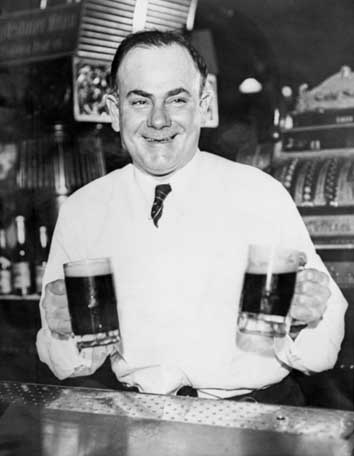
Image courtesy Minnesota Historical Society
Here’s Harry again, no doubt with some politicians who want to take credit for the end of Prohibition. Doesn’t look like Harry is buying it.
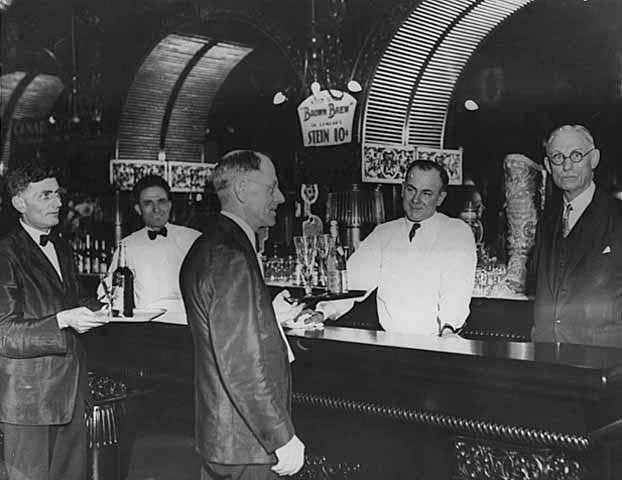
Louis Schiek expressed his concern about young people spiking their beer (and tavern owners facilitating thus) in an article in the Tribune dated March 23, 1933. He spoke of having to educate people how to behave in a high-class restaurant such as his. And he reiterated the opening date of June 30, 1894. He planned to have music, but not jazz – perhaps a string quartet.
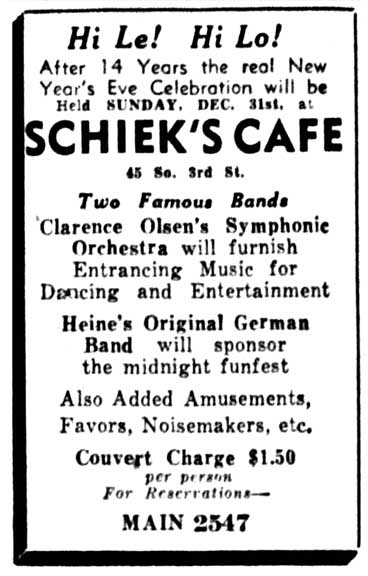
Minneapolis Tribune, December 1933
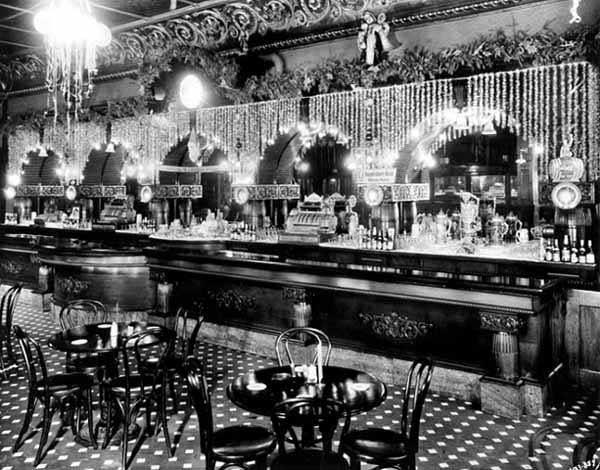
Schiek’s Bar, 1933. Photo courtesy Minnesota Historical Society
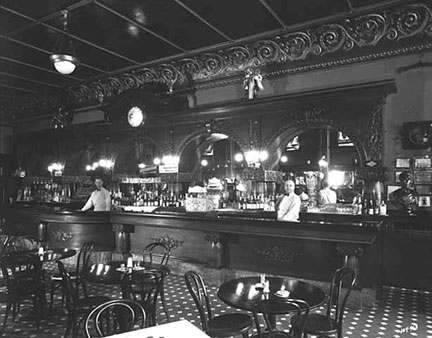
1934 photo courtesy Minnesota Historical Society
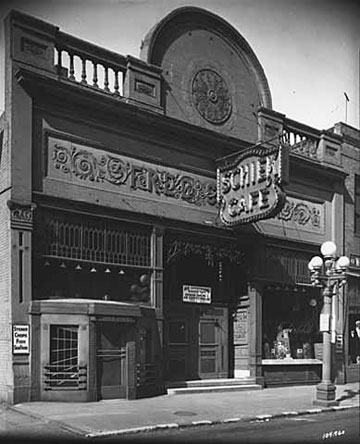
1934 photo courtesy Minnesota Historical Society
By November 1934, the Cafe was featuring Clarence Olson’s Trio, the Rhapsodion Trio, and Heinie’s German Band. Below, our host Louis promises Delightful Music with Soloists.
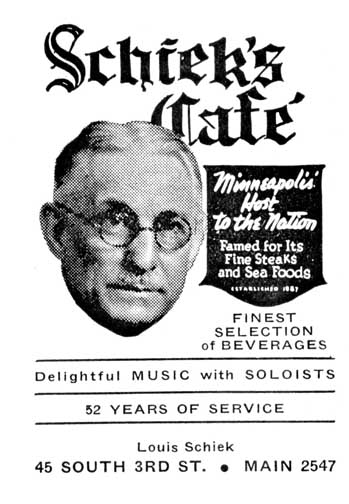
July 1939
Apparently the Rhapsodians had grown by 1936:
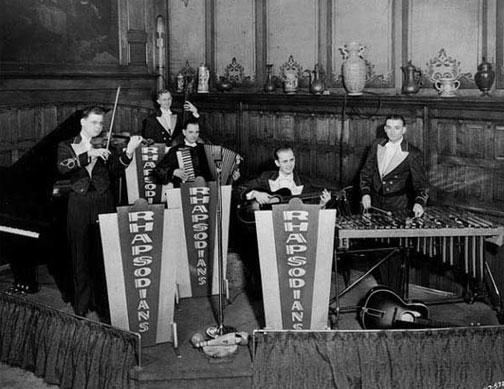
The Schiek’s Rhapsodians, November 1936. Photo from the Minnesota Historical Society
THE DEATH OF LOUIS SCHIEK
Louis Schiek died on July 10, 1941. Somehow the date 1887 was attached to the Cafe’s opening, when Fred Schiek was managing a saloon before he opened Schiek’s, and the legend continued.
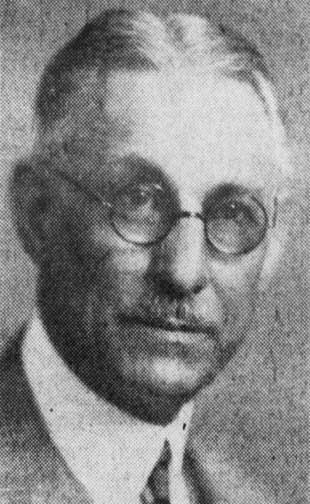
Louis Schiek, Minneapolis Star, July 10, 1941
BEN BERGER
In 1944 the restaurant was purchased by three men for about $50,000. Benjamin N. Berger was the operator of a chain of theaters, and in 1947 he founded and owned the Minneapolis Lakers with Morris Chalfin. Berger owned it until the cafe closed in 1971. W.A. Steffes was the operator of the World Theater. Harry Williams was the manager of the restaurant, assisted by Wilfred (Rosy) Ryan, baseball figure.
In 1945, the three owners applied for permission to transform the cafe into a “swank cabaret restaurant” so that they could install cabaret-type shows. (Minneapolis Star, January 10, 1945) There was much trepidation about the new owners would do to this City Institution.
The building next door was acquired so that the kitchen would be on the same floor as the restaurant, and a new lounge was installed.
In 1946, Schiek’s made a settlement to the Federal Government of $795 for overcharging for meals. During this postwar period, to keep inflation down, the Office of Price Administration had a list of prices a business could charge, and fines were assessed for overcharging.
RETURN OF ENTERTAINMENT
Beginning on December 29, 1949, Schiek’s began presenting what was called “a series of capsule presentations of musical comedy tunes,” delivered by singers in costumes. Numbers from “Show Boat” made up the initial offering. The cast included Jean Traun, Norma Gilbertson, Beverly Hanson, Carl Fox, Bill Loomis, and Wayne Hartley. Music was under the direction of Bob Beaulieu, and the show was staged by Glyde Snyder. (Minneapolis Star, December 30, 1949)
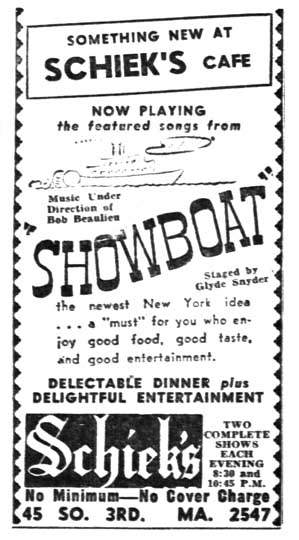
Minneapolis Star, January 1950
Sometime between 1952 and 1953, these “capsuled operettas” became the Singing Sextette, which did “musical comedy favorites in a most elegant old-world atmosphere.”
An anniversary article in January 1961 said that the group had never missed a night, and that 104 singers had participated since its inception.
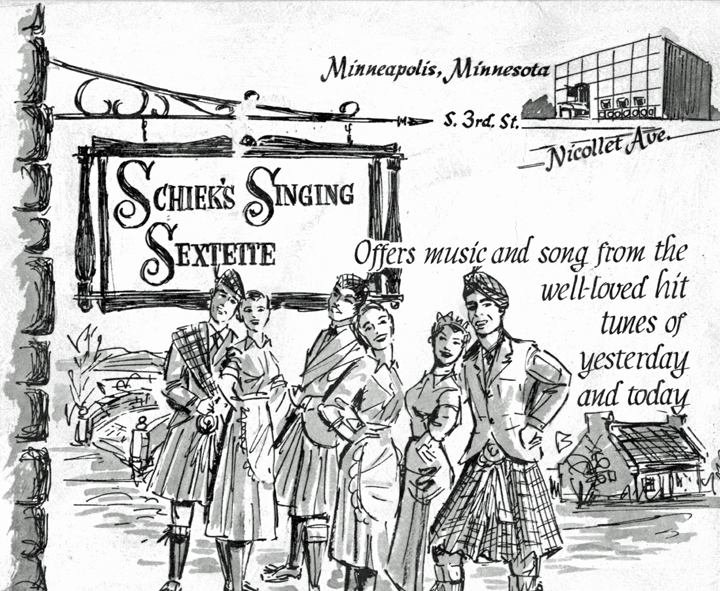
November 1955
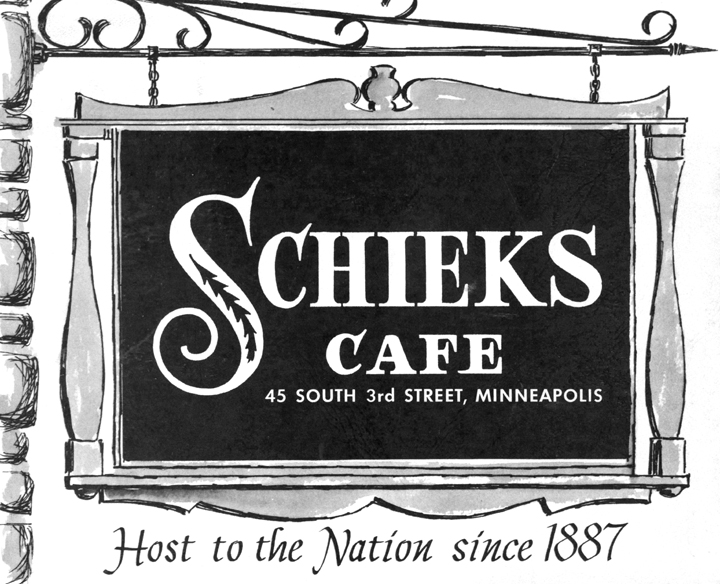
November 1955
In 1963, the Restaurant was sued by Cole Porter because the Sextette was using songs from “Kiss Me Kate” without his permission.
Sign of the times:
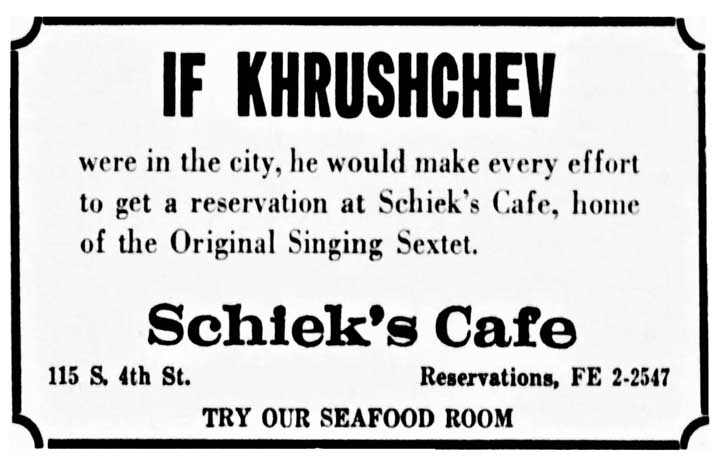
Minneapolis Tribune, January 13, 1964

1965 Ad posted by Alan Freed
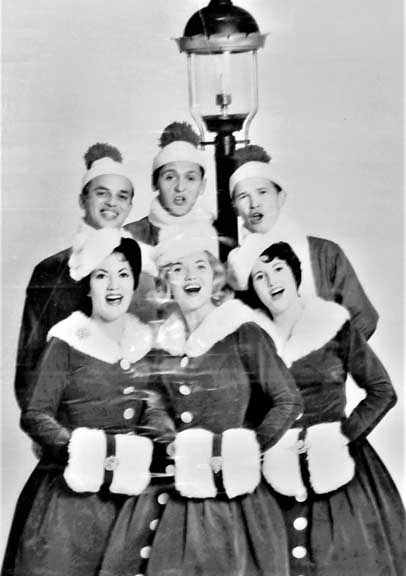
Schiek’s Sextette in the 1960s: Gordie, Don Powell, Ron Jacubec; Diane, Beth, Jackie White. Photo courtesy Don Powell
115 FOURTH STREET SOUTH
In 1959, Schiek’s was targeted for demolition because it was in the Gateway redevelopment district. At first Berger filed suit to save the building, but then withdrew his objections. It was acquired by the HRA for $167,000. The old building on Third Street was vacated in mid July, 1961, and demolished a few weeks later.
In 1961 Berger moved Schiek’s to 115 Fourth St. So., from General Mills, which had been using it for additional office space before it moved its headquarters to Golden Valley. Before that it had been the Farmers & Mechanics Bank building. Berger spent $250,000 to remodel the building, which was 3,000 sq. ft. bigger than the old building. It was a two-story building, but only the first story would be used at first. (Minneapolis Tribune, April 29, 1961)
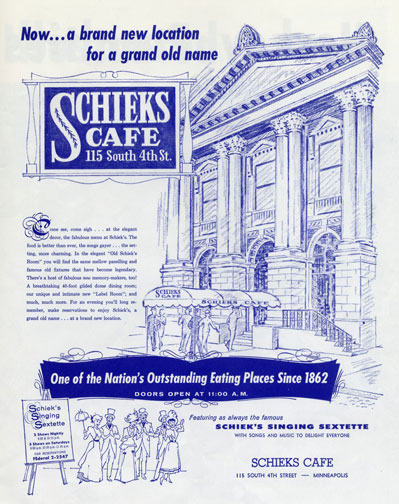
THE NEW SCHIEK’S
Will Jones gave his approval in his column in the Tribune on September 17, 1961. He provides a good description of the new place:
The old paneling and back-bar mirrors from Schiek’s have been moved (workmen merely walked up the street carrying them) and used to create on simple, high-ceilinged dining room full of the feeling of the old front dining room.
A larger room, to be called the Sextette room, is housed in what used to be the main banking floor of the old F & M bank. The Schiek’s Sextet will perform on a stage in an area that used to be a two-story-high vault. The customers will sit under a high glass dome.
The most important new item in the room will be a chandelier 10 feet in diameter, to be hung from the center of the dome. The bank’s old Italian marble walls have been shifted to accommodate new entrances, but mostly the marble has been left intact.
The cocktail bar, situated just to the left of the main entrance, will be called the Old Labels room. It will feature some old Schiek’s liquor and wine lables, found unused in a storeroom before the old place was torn down. They bear the legend Fred Schiek, 1862.
According to what we know, Schiek was a “merchant” in Lansing, Iowa in 1862 – probably a wine merchant, given his profession in Minneapolis. Some have mistakenly dated Schiek’s Cafe to this year.
Will described the lhe last major decorating problem left to be resolved: where to place Becky, a/k/a The Milkmaid. Becky was a “gilt plaster figure of a bonneted, full-skirted woman, with a wine goblet clutched in her right hand.” Becky couldn’t go back where she was over the bar or against a wall, for logistics sake. George’s deadline came and the decision was never revealed.
THE END OF SCHIEK’S
On July 31, 1971, Scheik’s was forced to close because of increasing operating losses. At the time it had 80 employees.
At some point it morphed into Schiek’s Palace Royale, a strip club.
In 2011 it was sold and renamed Downtown Cabaret.
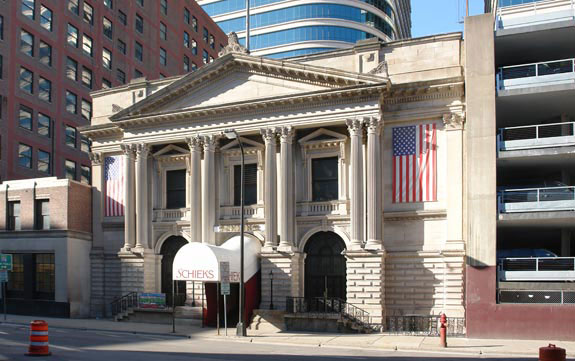
115 Fourth St. So in 2011
Schlief’s Little City was in Inver Grove Heights – Highway 55 and 218 (South Robert), the directions said in 1949.
The Dakota County Historical Society says that this building started out as a farm implement business. In 1937, Luella and Cleadis Schlief opened it as a dance hall. The building had 20,000 sq. ft. and a maple dance floor.
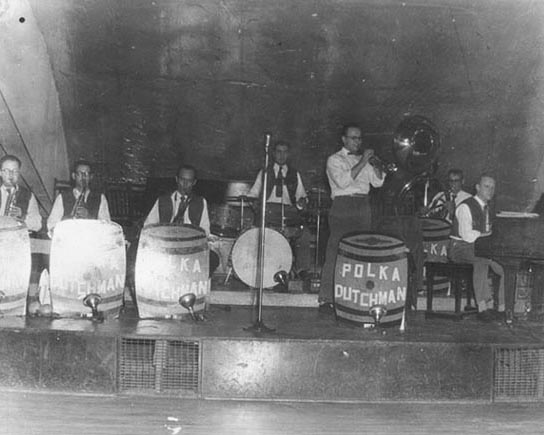
The Polka Dutchman at Schlief’s, 1940. Photo courtesy Minnesota Historical Society
Sandy Wilcox writes: “This was a dance hall that I remember going to with my parents when I was young. People brought their families and all their children and sat at long tables and danced to the polka & waltz. It was like a big wedding celebration. They served beer and soda pop. When they did the polka, the whole building would bounce. It was a great family place to go on a Sunday afternoon. You could easily see its big-letter sign from the highway, and it was quite a landmark.
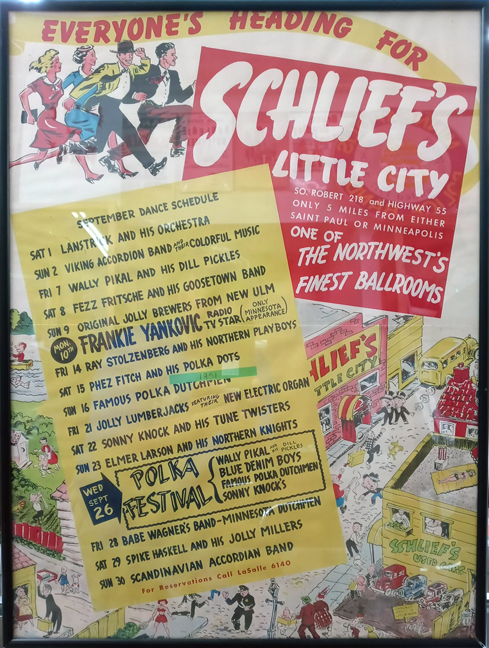
1951 Poster courtesy of the Minnesota Music Hall of Fame, New Ulm, via John Kass
The poster below is undated, but Frank Yankovic was a big deal and shows how popular Schlief’s was!
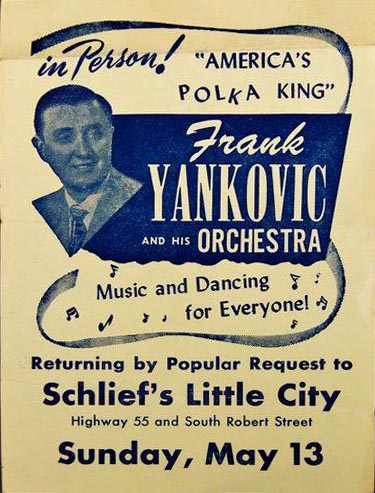
Courtesy Rick Schlosser
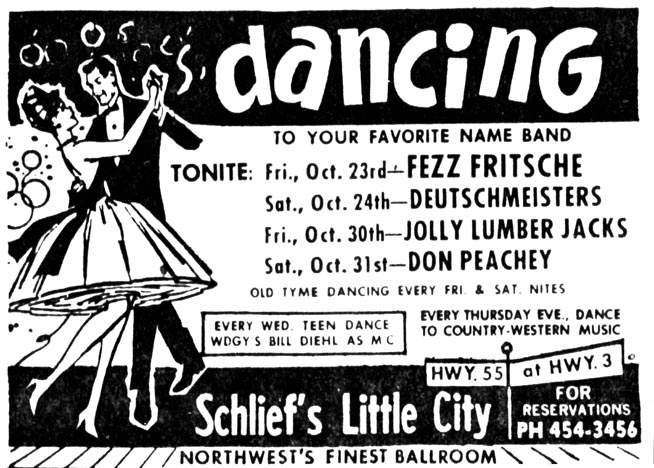
Minneapolis Tribune, October 23, 1964
Schlief’s Little City closed in 1974.
BROOKS BALLROOM
1975 – 1978
FEVER DISCO
Spring 1978 – several months
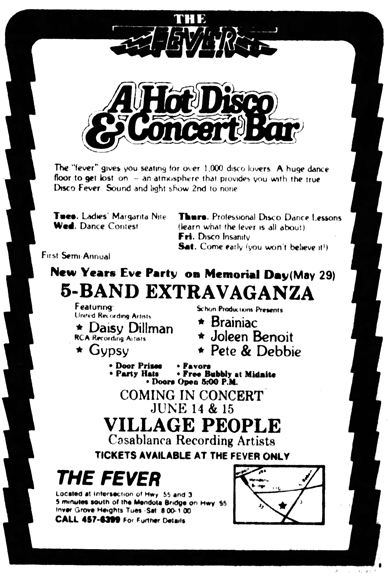
The Fever, May 1978
THUMPER’S SOUTH
The next iteration of the building was Thumper’s, which opened in December 1979.
PEABODY’S
Due to the popularity of the “Urban Cowboy” phenomenon, it became a huge country and western bar called “Peabody’s Saloon and Music Hall.”
Peabody’s burned to the ground in in an early morning blast on February 14, 1984. Randall Quade reports that “No remnants of the bar exist and the site is covered with a new commercial development.”
Save
Save
Save
This page includes extensive quotes cited as Jon Bream. It comes from an article about Coffeehouses in the Minneapolis Star dated December 16, 1975.
The Ten O’ Clock Scholar, perhaps true to its beatnik reputation, is difficult to pin down.
Jim Helling
Most agree that the Scholar was started by Jim C. Helling. But Helling’s obituary says that he opened the Scholar in Dinkytown, by the University of Minnesota – Minneapolis Campus in 1953, opened another on the St. Paul campus of the University of Minnesota, and closed them both a couple of years later. Helling went on to develop Gallivan’s, the Fox and Hounds, and Eddie Webster’s in the Twin Cities. He would operate each restaurant for a year and turn them over to someone else. (Minneapolis Tribune, June 29, 1994)
Another article says that the Scholar had its start on the St. Paul campus in the mid fifties and moved to Dinkytown in 1958. (Allan Holbert, Minneapolis Tribune, July 3, 1966)
Obviously this doesn’t compute.
418 – 14th AVE. SE
Building History
This building was built before 1888. In 1927 – 1935 there was a restaurant at the location, which was for sale during the 1930s. There were also apartments in the building. In 1945 it was the Campus Exchange, where you could trade your used clothing in. Later that year it became Campus Wardrobe.
1958
The first mention of the “Ten O’Clock Scholar” in the Minneapolis papers is on December 8, 1958, announcing an art show by Roberg Berg.
Bream wrote that it opened in 1958 in a former restaurant at this address:
The small storefront, which served sandwiches and espresso coffee, attracted local foot traffic at first. It became a hangout for aspiring guitar players and chess-playing university types who held “self consciously intellectual discussions,” said Scholar regular Dave Matheny, who lived next door to the coffeehouse and painted its window sign.
In his survey of coffee shops called “Java Jive” in the Tribune’s Sunday Magazine (February 18, 1990), Jim Fuller described:
It was dingy to the point of looking 50 years old the day it opened. It served bad coffee, decent teas and some soft drinks and snacks – it was two or three years old and into a second or third set of owners before it acquired an espresso machine. Performers, mostly folk singers, sat in front of the store windows, just to the right of the door as you came in. Mostly they worked for whatever the student patrons would drop into the hat or cup or whatever was used for tips.
It soon became one of the area’s best known folk music venues. The 4-inch raised stage stood in front of a large plate-glass window. The long room held maybe 50 customers on unmatched tables and bar stools, and there was a long bench along the wall. In the back was a coffee bar that also included 30 different kinds of tea. During the day it was a coffee shop where customers could hang out and play chess. At night there was poetry and music – not just folksingers, but flamenco and blues musicians as well.
John Koerner
The photos below were taken by University student Bill Savran in 1958. These photos are used by permission.
Savran wrote of the Scholar and of Koerner:
The folks that gathered at The Scholar were philosophers, alcoholics, grad students, writers, poets, wannabe writers and poets, hangers-on, musicians of all kinds: strummers, singers, tambourine shakers, bongo thumpers, mouth harpists and so on. Spider John Koerner was a standout and of unique natural talent. I met him the late summer of 1958, in San Francisco, just after he had been discharged from the Marines.
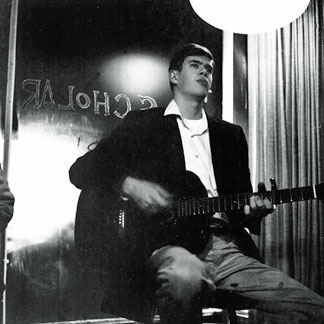
Spider John Koerner
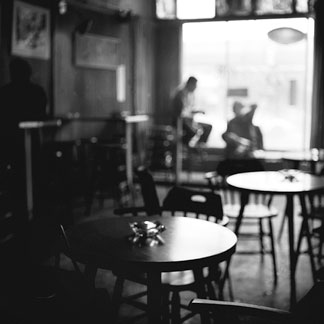
Dave Lee
Bream:
An informal, folk music performance policy developed under the Scholar’s second owner, Dave Lee, and the performers were paid.
1959
Zimmerman Becomes Dylan at the Scholar
The Scholar is, of course, famous as the place a young Bob Dylan performed from approximately September of 1959 through December of 1960. In his piece “Dylan’s Fortune,” (March 27, 1966) P.M. Clepper wrote that Dylan sang “traditional country-western songs in a nasal monotonous voice.” Dave Lee wrote that he regularly kicked Dylan out. “Dylan would come in and sing, and for a while it was all right, but that monotone would go on and Muriel would say to me ‘They’re beginning to leave. You’d better get rid of him.'” Clepper: “But he kept coming back, singing as if only for himself.”
When the Scholar was sold, Dylan got $2 a night because he was developing a following. But when he was refused a raise to $5, he moved on to the Bastille, and then got $6 at the Purple Onion in St. Paul.
Bob Fishman and Clark Batho
Bream:
The Scholar gained notoriety under its third owners, Bob Fishman and Clark H. Batho, who parked his Cadillac in front and told the chess players to “clear out when the paying customers came,” recalled Matheny, [who became chief artist for the Minneapolis Star.]
The University police occasionally checked the Scholar to verify complaints from “concerned faculty and parents,” according to [police], who characterized the place as a hangout for juveniles and runaways. He said the drug trafficking there was “heavy enough to issue a number of warrants and make a number of arrests.”
There followed a period of what Matheny and other members of the coffeehouse crowd characterized as harassment by police and restaurant licensing inspectors.
In 1961 the club was denied a food license and police closed it when they found out that Batho was serving food without a license. Batho was fined $25. Lt. A.G. Kirby of the University Police told the city council that the coffee house was “a hang-out for juveniles” and that one teenage girl was found there carrying a pistol.” Kirby also said that “teen-age patrons were consuming ‘large’ quantities of codeine cough medicine. He said at least eight bottles were recovered from the coffee house trash can.” (Minneapolis Tribune, November 21, 1961) Batho was selling real estate by January 1963.
1961
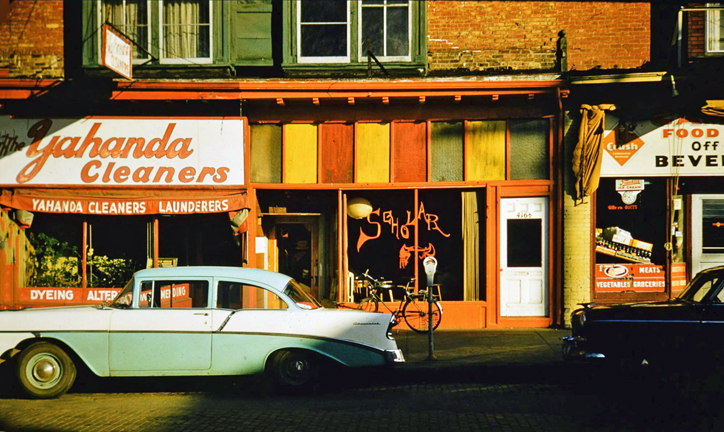
418 14th Ave. SE, April 1961. Courtesy Hennepin County Library
1962
A notice from December 1962 advertises folksingers every weekend and evening beginning at 8 pm. Sundays Maurice Bernstein sings Yiddish, European folk songs.
1963
Ann Oleson and Genie Evans
In 1963 Will Jones noted that it was purchased by Ann Oleson and Genie Evans that summer, and they celebrated by holding a Hootenanny.
Bream:
By 1963, Matheny said, “Id walk into the Scholar and it was packed with people I didn’t know.” By then, he added, regulars could make connections to buy marijuana through people who frequented the Scholar.
The July 1963 Twin Citian described “singing entertainment on weekends with good sandwiches served in an off-beat coffee house with murals adorning the walls. Particularly good for people watching. Here the students gather to converse, [???] and think.”
1964
Red Nelson
James “Red” Nelson bought the Scholar for $5,000 and a motorcycle. Red’s partners were Ann Mossman and Steve Oleson. Red Nelson would have afterparties at places called:
- The Red [Brick] Palace
- Ground Zero – across from 7 Corners
- Rainbow Gallery – a jazz place (see separate entry)
- The People’s Club – on Cedar Ave.
Bream:
Red Nelson called it a place “to hang out, play chess and go and talk – there was a lot of existentialism in those days. You had to have intellectual moxie. Professors would get into long philosophical discussions they couldn’t have in the classroom.”
As a business, the Scholar led a “hand-to-mouth existence,” said Nelson, a former member of the Minneapolis Park Board who was [in 1975] collecting workman’s compensation. The Scholar, which was usually open from noon to 2 am, charged 50 cents admission for its 80 or so seats on Friday and Saturday nights for performances of such local folk artists as John Koerner. Occasionally the place brought in nationally-known musicians, including Blind Lemon Jefferson.
THE GOPHER
The photo below appeared in the 1964 University of Minnesota Gopher Yearbook.
This might be an unattributed quote?
Several months after Dylan arrived on campus in Sept. 1959 he walked into “The Scholar” and said “Do you mind if I play? I want to be a folk singer.” According to Anthony Scaduto’s Dylan bio. . .He would soon be playing alongside “Spider” John Koerner who also often played with Dave Ray. . .There was a 4-inch raised stage in front of a large plate-glass window. The Scholar, as it was nicknamed, was a long room holding 90. It had unmatched tables and bar stools and a long bench along the wall. In the back was a coffee bar. A coffeeshop and place to hang out and play chess by day, at 9 pm folksingers, flamenco and blues guitarists, and poets would take over. . .Dylan would play here off and on between 1959-1960 until he moved to NYC in January of 1961. . .
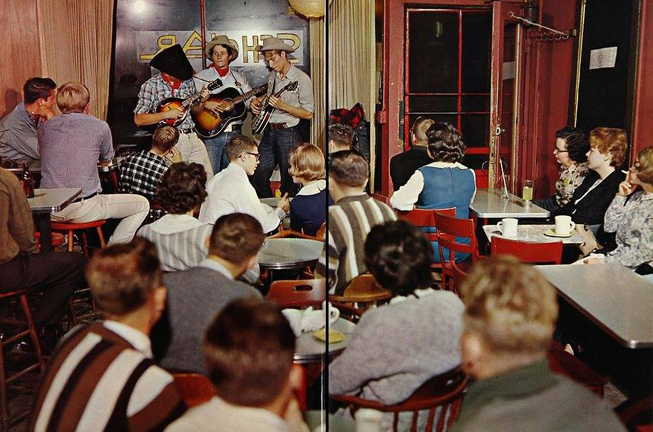
From the 1964 University of Minnesota Gopher Yearbook
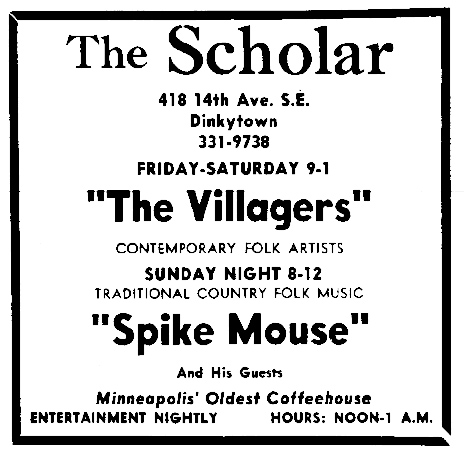
Minnesota Daily, 1964. Courtesy Robb Henry
1965
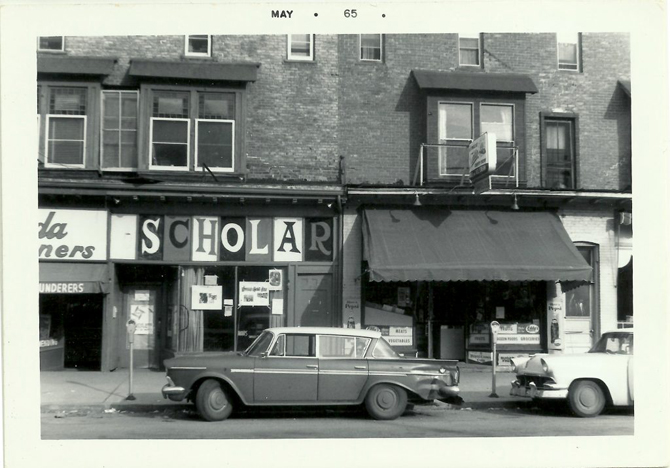
Scholar May 1965. Photo courtesy Johnny Hanson
The building on 14th Ave. SE was demolished on January 9, 1973. Its space became part of a larger Subway sandwich store.
247 CEDAR AVE.
Mike Justen, “a young automotive parts man,” bought the Scholar in May 1965, and moved it to a former bar on the West Bank. It was closed by a fire in December 1965, apparently started in the grocery store next door. (Minneapolis Tribune, July 3, 1966)
1966
Although remodeling was incomplete, Justen opened at the new location in June 1966 and was met by standing-room-only crowds. Reporter Allan Holbert described it as a place where “college couples sit in front of abstract student art as they listen to abstract student jazz and drink abstract (but non-alcoholic) beverages.” (Minneapolis Tribune, July 3, 1966)
The new Scholar held about 100 people and served sandwiches, pizza, and coffee. Guitarist Leo Kottke noted that “when the pizza machine broke down it would interfere with the sound system.” (Bream)
Kottke made his first public appearances at the Scholar, noting that performing before audiences that are not drunk but paying attention taught him a lot. He recorded his first album live at the Scholar. (Bream)
1967
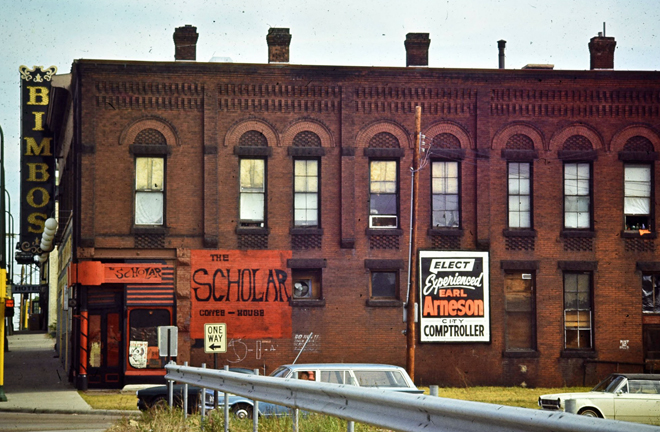
247 Cedar Ave., June 1967. Photo courtesy Hennepin County Library
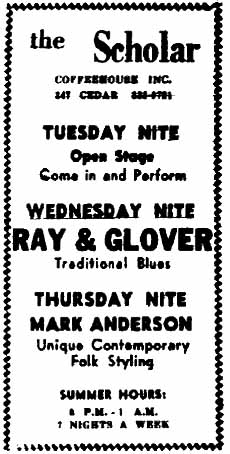
Minnesota Daily, no date. Courtesy Robb Henry
Steve Brust
Steve recorded his memories of the Scholar from 1965 to 1969. The following are some excerpts:
For me, starting in 1966, the Scholar Coffeehouse was an alternate home. And it was a fascinating place. The place was run by Mike Justen (I’ve seen the name spelled Justin), a casual and bright guy who was mellow unless he heard customers talking during a set, at which point he could bark with authority to restore an atmosphere of respect for the musician. The Scholar was a place to go if you were serious about enjoying what was being called folk music at the time.
The headline act, beyond question, was Leo Kottke. I think Leo played just about every other weekend. Sometimes he’d play at a tiny basement coffeehouse on the Macalester Campus, the Purple Onion, but the Scholar was his home in the Twin Cities.
Other acts included Papa John Kolstad (with or without the Sorry Muthas); Bill Hinckley and Judy Larson; the Middle Spunk Creek Boys; Koerner, Ray & Glover; Jeff Titon; and the duo of Jeff and Kit. I’ve forgotten many!
There were also fascinating people who hung around the place, including Maury Bernstein and Stephen Gammell (who had been a guitarist but is known now as the illustrator of children’s books).
The Scholar had seating for about 30 people. With no liquor license, the audience was very alert and generally respectful.
The Scholar was a great place to hang out. Mike could tell stories by the hour. When the lights went down, the place was pretty serious about music. The front door was terribly squeaky, and if you have a copy of the record Leo Kottke recorded there you’ll hear that door on one of his numbers.
I was convinced that Leo was a major talent, so I caught every performance of his that I possibly could attend. He was just as impressive musically and just as flaky as he ad-libbed between numbers as he is now. To hear him in an audience of 15 or 20 young folks whose faces were lit by tabletop candles was intimate, moving and memorable.
1969
The last hit in a search for the Scholar at 247 Cedar was on November 2, 1969. The location, plus the burned out former Bimbo’s building, became the new home of Theater in the Round.
At that point Mike Justen and Dennis Bursch opened the Oblivion Record Store with 50 albums in the front of the Scholar Coffeehouse. Oblivion closed in 1973.
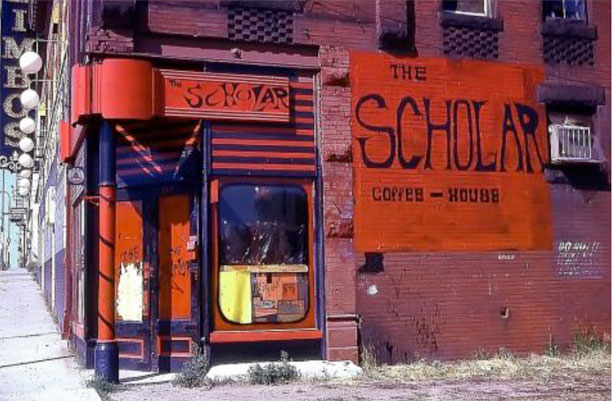
247 Cedar Ave., West Bank
In the book West Bank Boogie by Cyn Collins (2006), Red noted that Ken Kesey and his Merry Pranksters pulled up to the Scholar in their bus one day, and drugs became the downfall of the mellow folk scene.
The Schooner Tavern is located at 2901 27th Ave. So. in Minneapolis.
According to Hennepin County tax records the building was built in 1901, but permit records show that William E. Tuttle was the contractor and perhaps the owner who took out a building permit to build a hotel and stores on August 9, 1905. The projected cost was $7,500, and the original footprint was 36 x 90. Wendy Kremer, present owner of the Schooner, says that in the early 1900s the business operated as a railroad hotel for workers, and that she found a reference to the Tuttle and Rens Hotel.
In 1912 another permit was pulled to build a 36 x 95 addition to the hotel for $5,000. The permits only give the name of the contractors – in this case, it was J.A. Benson.
In 1919 a permit was pulled for a restaurant. Wendy:
We suspect that the bar was operated as a speakeasy prior to the end of Prohibition, as evidenced by several hundred bottles we discovered buried upside down under a basement floor.
THE CONNORS
The obituary of Patrick J. Connor says that his father, Robert had started the tavern in 1934, although it appears from the ads below that it opened in or before August 1933. (Beer became legal on April 7, 1933, and taverns sprang up all over pretty much immediately before cities began to license them.) This is consistent with permit records, which show references to a dining room and beer garden on August 27, 1933. There was a lot of electrical work done in December 1933, which may have been the installation of beer lights once a 3.2 permit was obtained.
The first ad found in a search of the Strib database was this:
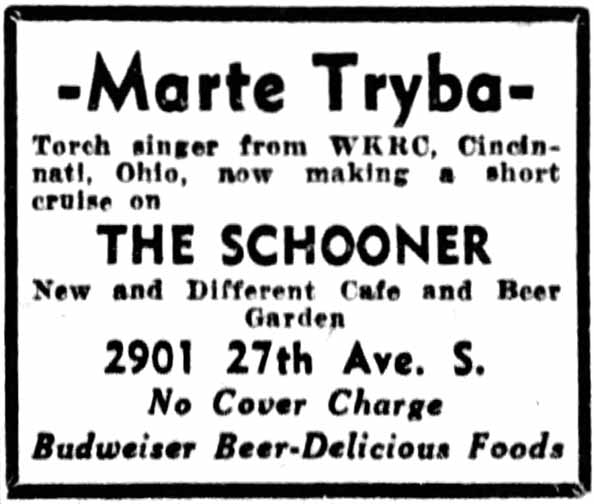
August 12, 1933
And this bit of poetry advertises the place as an elite night club!
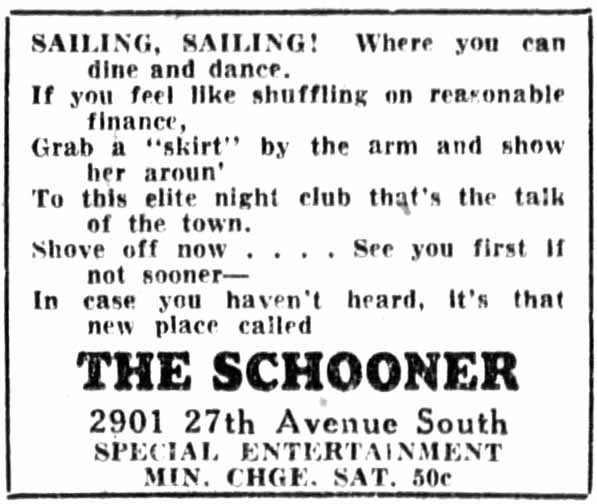
September 1, 1933
Home Cooking!
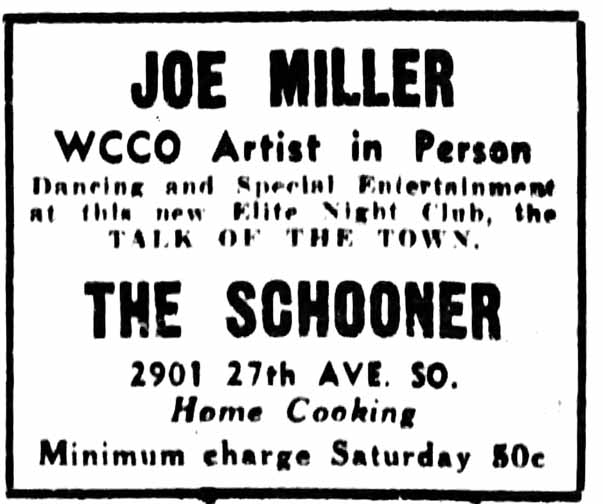
September 16, 1933
The on-sale license granted to Harry Walton McNamara on March 14, 1934, listed his location as the Schooner Hotel. I can’t be 100 percent sure whether this was the address of his establishment, or where he lived.
On August 9, 1935, a building permit was approved for a $1,000 addition on the south side.
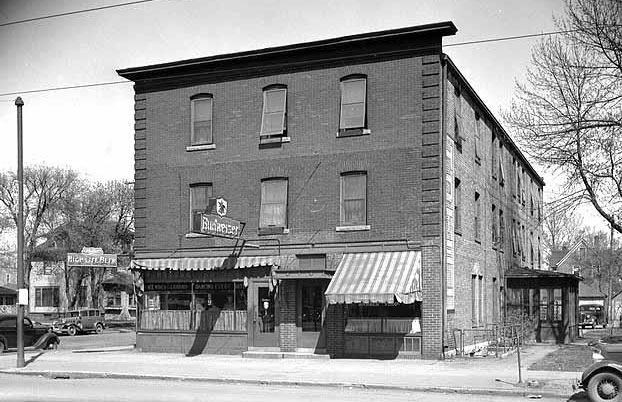
May 1937 photo courtesy Minnesota Historical Society
The photo below comes from archives of the Minneapolis Musicians’ Union. Pictured are:
- Benny Ryan, drums
- Einar Brustad, piano
- Hugo Bursch, violin, trombone, and saxophone
- Barney Bakula, trumpet
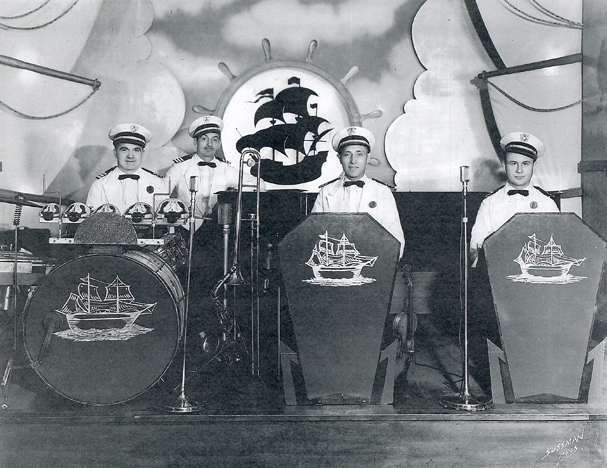
1937 photo courtesy Minnesota Historical Society
A permit for $1,000 in alterations was pulled in December of 1938, and a lot of improvements were made in 1939.
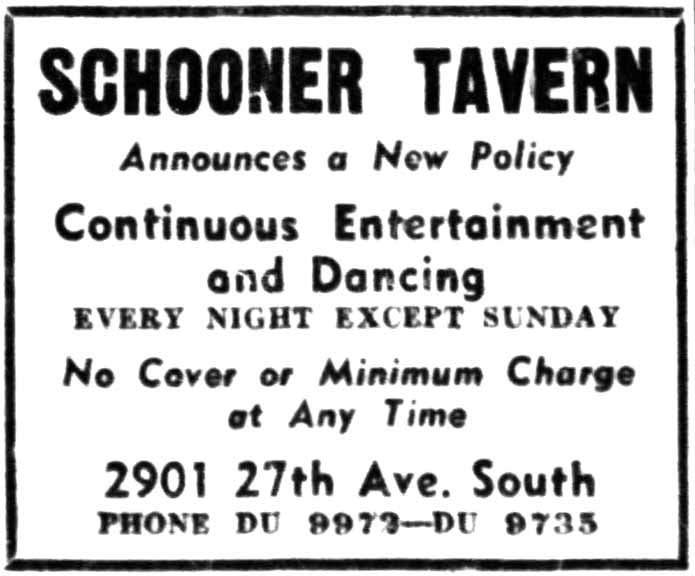
January 22, 1939
A classified ad in the Minneapolis Tribune, January 29, 1939, read:
Visit the coziest night club in the northwest. Floor shows and dancing every night except Sunday. THE SCHOONER TAVERN
In 1942 the male musicians must have been in the military, so the women took over the entertainment duties. The photo below is from the archives of the Minneapolis Musicians’ Union. The handwriting is difficult to read, but it looks like Laura Sliarn and Her Orchids. Pictured are:
- Laura Sliarn, piano
- Lillian Brenner, vocalist
- Jackie Peterson, drums
- Alice Larson, violin
- Myrtle Winslow, Saxophone
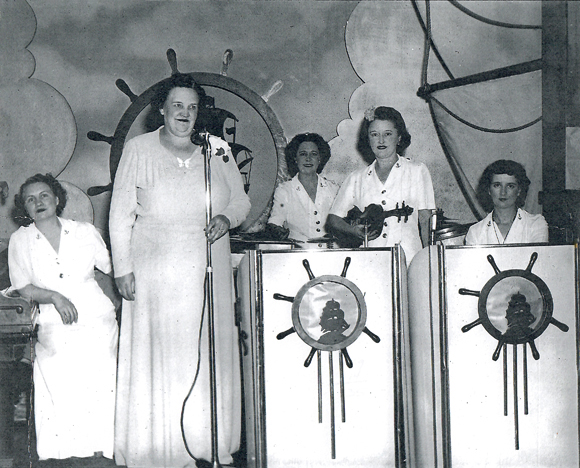
1942 photo courtesy Minnesota Historical Society
“South Minneapolis’s Best Night Club,” so said the Republican Register in 1943 to 1944. “Choice liquors – 6% beer – Dine and Dance.”
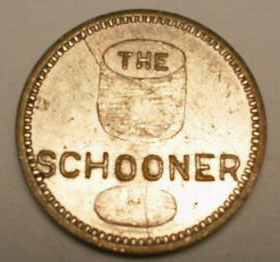
Photos above and below courtesy Wendy Kremer, Schooner Tavern
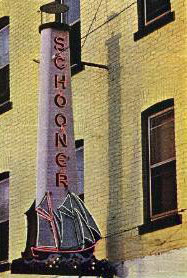
Owner Robert Connor died on January 10, 1961, and Robert’s wife Vienna operated the business until her son Patrick became of age. Patrick graduated from the U of M and earned his law degree from William Mitchell College of Law. He worked for Hennepin County for several years before opening a solo law office above the Schooner. He had a full-time manager to run the bar. Patrick died in August 1992 at the age of 39, and was listed as a co-owner of the bar, perhaps with his mother.
December 3, 1977, was advertised as Sailor’s Day, with special prices.
Wendy sent along a description of the Tavern from Mpls. St. Paul Magazine, July 1979, which is cute:
Never mind that south Minneapolis is a thousand miles from the ocean. The Schooner sails with a full cargo of nautical themes: ship’s wheel, a mural, framed paintings, hawsers coiled ’round mast-like pillars, lanterns and a ship’s rail that sets off the bank of pinball machines. You enter past a long, huge bar, into a large room filled with dozens of tables. In proper tavern fashion, locals can cash checks on payday. The clientele is a mixed bag of white and blue collars, old and young, and students. Behave yourself – the 3rd precinct police station is across the street. But if the floor pitches and seas are rough, the bar owns a hotel on the two floors above $17 weekly; the manageress, however, tolerates no hanky panky). Anchors aweigh!
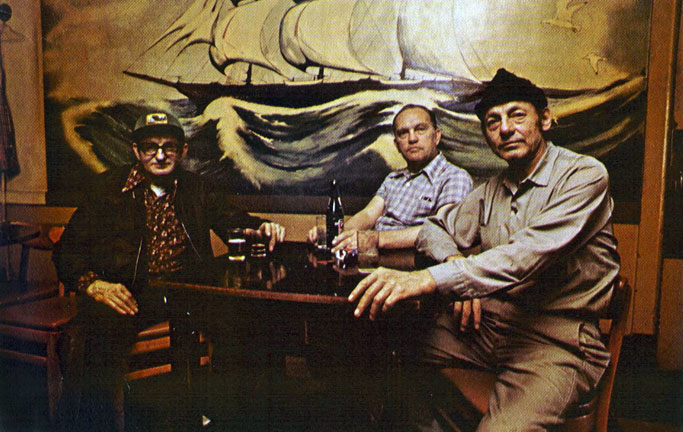
Schooner Patrons, 1979
TRAGEDY AT THE SCHOONER
On October 16, 1986, James F. Nelson, celebrating his 39th birthday, was killed during a robbery at the Tavern. One of the robbers stood in the doorway wearing a ski mask and another demanded money from the bartender. Nelson, standing by the doorway, turned to the robber and said “Not in here, you can’t do this,” and tried to shove him out the door, but he was shot in the chest. He died two hours later at HCMC. Nelson was awarded the Medal of Valor by the Minneapolis Police, awarded to his 13-year-old son. On November 23, a benefit was held, raising $15,000 for the son’s education. In attendance was heavyweight boxer Scott LeDoux.
The men responsible, Gerald Wayne Norris and Jerry DeWayne Clark, were also accused of robberies at 10-12 other bars and restaurants. Clark testified that Norris pulled the trigger, and Norris got life plus 25 years. Clark also got life in prison.
On November 6, 2004, Audrey Lynn Starr died – her obituary stated that she co-owned the Schooner with her husband Joe.
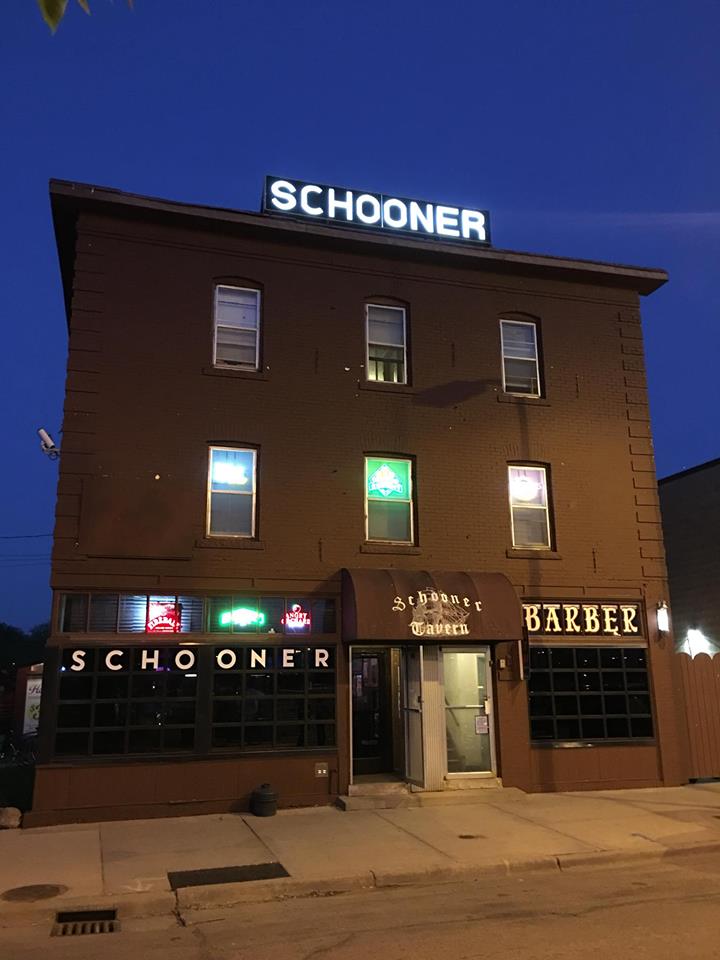
New look, 2018!
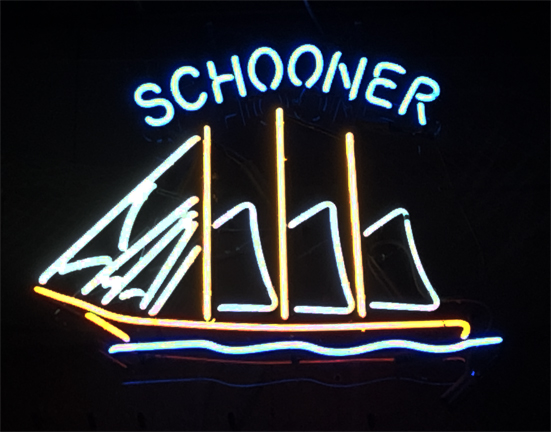
Neon above the back bar
2020 RIOTS DAMAGE THE SCHOONER
During the riots following the murder of George Floyd on May 25, 2020, the Schooner Tavern suffered significant damage from fire and water. Twenty tenants living above the tavern had to be evacuated. Looting began literally minutes after previously planned renovations had been completed. Though the building still stood, the losses were extensive. A gofundme page was set up with a goal of raising $60,000 to fund repairs and renovations to the building.
I personally love this place and I urge you to donate to keep it alive as a a venue for live music (and dancing) in the Minneapolis community.
7345 Sixth Ave. No., Golden Valley. 1957
This tavern in the middle of nowhere was built in 1926, according to the County database.
The sign at Schuller’s Tavern says it was established in 1929, which was nearing the end of, but still during Prohibition – that never made any sense to me.
Methinks this place is much older than that.
THE POINT
Not to be confused with the Point Supper Club on Golden Valley Road, this Point was “notorious” and had to be shut down. But let’s start from the beginning, or as early as I could find.
On June 30, 1906, Fritz Hozapxxx (the page was folded over) applied for a liquor license for a tavern at Sixth Ave. No. and Watertown Road in Golden Valley. Watertown Road later became Western Ave., and is now Glenwood Ave. Sixth Ave. No. was pretty much obliterated by Highway 55, but there were shards of it remaining. This section of it was eventually renamed Country Club Road.
In August 1907 and June 1908, Fred P. Scheffel applied for a liquor license at the same address.
In September 1910, Herman Yake applied for a liquor license at this address, which was referred to as Golden Valley Point. Yake presided there until at lease March 1912; an article at that time said that it was the only saloon near the Golden Valley Village Hall, so Yake had to remain neutral in matters of politics.
By March 1915, Yake had moved on.
HUB SCHULLER
An item about a cattle auction tells us that on or before November 5, 1915, Hub Schuller was the Proprietor of the Golden Valley Point Saloon. Plymouth Ave. and Sixth Ave. No. I guess he was new at this, since Plymouth Ave. was at about 13th Ave. and parallel to Sixth Ave. No.
In 1918, Hub Schuller reported that he was a retail liquor dealer on his World War I registration card.
Prohibition officially began in January 1920, and on the 1920 Census, Schuller reported that he was a soft drink merchant. It appears that he soon sold the business, however.
THE LANGFORD MURDER
On April 2, 1921, a shooting occurred that riled the community against The Point to The Point that The Point was shut down.
A man named Morris Posnick, a whiskey smuggler, said he was an old friend of the victim, deputy sheriff Arnold C. Kaech. Posnick gives about as good a description of the night as anyone:
About midnight of April 2, 1921, I was taking lunch with some friends at the “Chicken Barbecue” on Sixth avenue north near Lyndale, when [Ray] Langford and some colored friends of his came in. I had known Langford for a year or two, though not intimately. It was suggested that Langford and his friends go with me in a new car I had recently bought to “The Point,” a sort of road house at the intersection of Western [Glenwood] and Sixth avenues north.
It was there that we met Kaech. With him were Emmit Doran, Martin Burfenning and John Knaeble. I bought a drink of hard liquor there for the crowd and Langford suggested that we go down to his place. I took Langford and his friends back to the Chicken Barbeque where Langford had left his car. Kaech brought the others in the machine he was driving.
We all went to Langford’s place and started shooting craps. I quit playing after 20 minutes or so. The others played for a little over an hour when Mrs. Langford came into the room with an automatic revolver in her hand. The first I knew the gun was discharged and I saw Kaech making a pass at the woman to get the gun away from her. He said “I am hurt” or something like that. Several of us tried to get the gun. I took it out of the woman’s hand and put it in my pocket. Later, when the police officers came I turned it over to them.
Mrs. Langford (described in that era’s press as “negress”) testified that she was not feeling well and was trying to sleep but the boys in the kitchen were making a racket with their dice game, and she got mad and pointed a .38 at them to try to get them to leave. There was a wrestle for the gun and it went off, killing the white deputy sheriff who was one of the dice players.
Mrs. Langford was tried and convicted of first degree manslaughter. Although the jury recommended leniency, on May 6, 1921, she was sentenced to 5 to 20 years in prison. Numerous petitions were submitted asking for her release, including those from two jurors in the case. Margery Langford was pardoned and released in July 1921.
At the time of the incident, The Point was owned by W.C.J. Herman and leased to J.O. Keefe. Emmett Doran, aka Emmett Casey, was named as manager of the roadhouse during the trial. Other operators of the saloon named were Max Zimmerman and Henry Sommers.
On May 31, 1921, a large delegation of Golden Valley residents called upon two Hennepin County assistant district attorneys, asking that “vigorous action be taken” against The Point. They stated that liquor has been sold there for some time with no real effort made to conceal it. “Drunken automobile parties are familiar sights in the valley because of this.” (Minneapolis Star, May 31, 1921)
On June 11, 1921, the “Notorious Joint” was closed by court order for a year.
SCHULLER’S GAS
Hub rode out Prohibition by operating a gas station in front of the tavern. He had it at least from November 1921 to 1942, when it burned down. The station must have done good business – the 1930 Census showed that he lived in a $12,000 house on Sixth Ave. No. in Golden Valley, and had four boarders. Indeed, in 1929 and 1933, the Schullers could be found in the Society Pages!
HUB SCHULLER’S TAVERN
Beer became legal again in April 1933, and presumably Hub opened right back up, this time naming the place Hub Schuller’s Tavern. The first evidence I found of this wasn’t until April 1937, however. The papers gave the bar’s bowling team’s scores, starting in about 1939 – they bowled at Ascension Alleys.
In July 1941, the Golden Valley Commercial Club’s annual picnic was held at Schuller’s Grove, which was right at the bar. Picnic-goers were urged to bring old pots and pans for the Government to use for the aluminum.
On January 9, 1942, a huge fire destroyed Hub’s gas station and damaged the tavern.
Hub died on March 27, 1942, at the age of 59, after a long illness. He is buried at Ascension Cemetery in New Hope. His obituary in the Minneapolis Star said that he had been “Prominent in business and civic affairs of Golden Valley for 32 years,” citing membership on the GV planning commission, the Knights of Columbus, the North Side Commercial Club, and the GV Golf Club.
In May 1945, a hold-up report revealed that Marvin Schuller, Hub’s nephew, was in charge at the time.
On June 6, 1946, there was a Dram Shop suit. Hub’s widow Clara was the presumed owner. The place was still being called Hub Schuller’s.
On June 15, 1955, a fire caused $100,000 in damage to the two-story, log cabin building. LeRoy Schuller, Hub’s son, was the manager. The address was given as 7348 Sixth Ave. No.
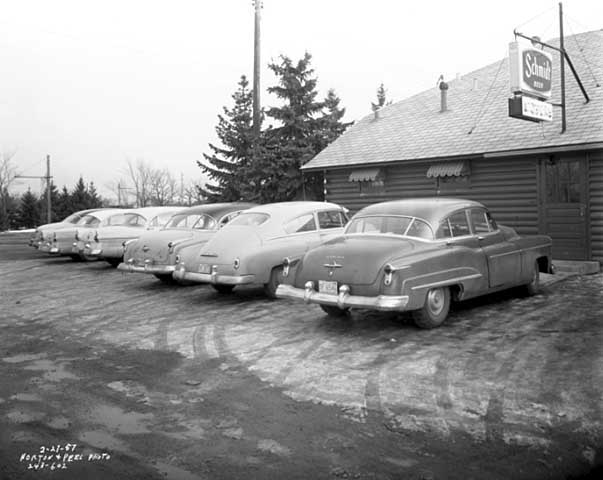
February 21, 1957. Photo courtesy Minnesota Historical Society
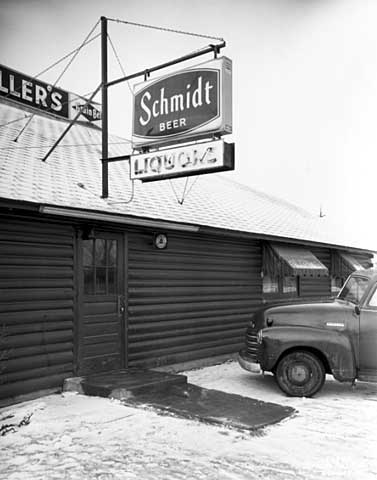
1957 Photo Courtesy Minnesota Historical Society
Aha! Proof that there was music in the old days of Schuller’s!
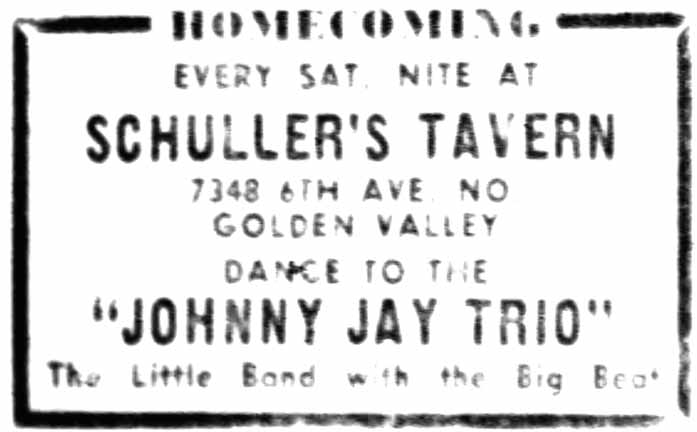
October 31, 1959, Minneapolis Star
On July 21, 1960, the Golden Valley Village Council suspended the tavern’s license for 10 days for serving liquor to minors. On June 17, 1960, cops had found a teenager staggering on Olson Memorial Highway. The kid said he was with a group of minors who were served at Schuller’s. The teens and five employees plead guilty. The minors were fined $25 for each of eight charges; three for false ID and five for drinking liquor as minors. The judge levied $100 fines, with $50 suspended, against Clara, two bartenders, a waitress, and the manager. Clara wasn’t there at the time. (Minneapolis Star, July 21, 1960)
In June 1961, Clara transferred the liquor license to a corporation made up of herself, son LeRoy, daughter Donna Mae Kuiper, and daughter Kathyleen M. Reiser.
In 1974, the tavern was advertising turquoise booths for sale, indicating some updating. What I’d give for a turquoise booth!
Clara died in May 1976 at age 88.
Today the address is 7345 Country Club Drive in Golden Valley. The exterior retains its log cabin look, but the interior is a little plain. But there is lots of live music!
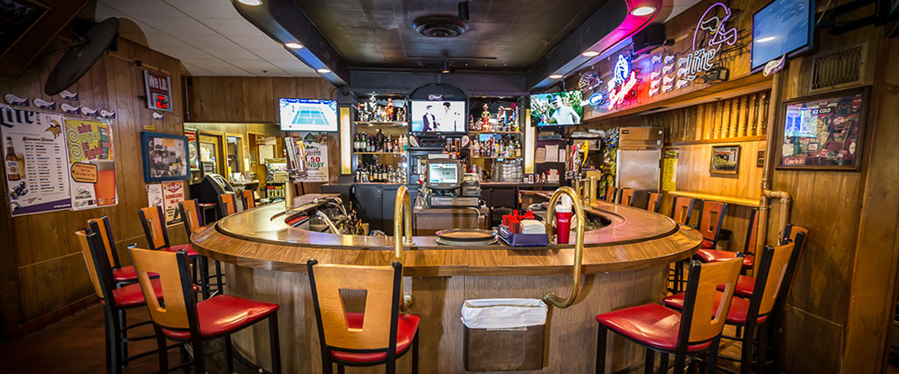
Photo from Schuller’s website
MORE ON HUB SCHULLER
Couldn’t help but do some research on the namesake of Schuller’s Tavern. Here are some bits and pieces from Ancestry.com:
Hubert Mattias Schuller was born on May 2, 1883, probably on his parents’ dairy farm in Crystal Lake Village (now the City of Crystal), Minnesota. His father Matt and his Mother Elizabeth (called Lizzie) were both born in Minnesota.
Hub only had an 8th grade education. In 1900, at age 17, he was a driver on a milk wagon, perhaps for his father. In 1910 he continued to live and work on the family farm in Crystal Lake.
On September 25, 1918, he registered for WWI, although he was 35 years old. He wrote his name as Hubert Matt Schuller, and his address as Robbinsdale Route 2. He gave his profession as Retail liquor dealer. The card asked for any disabilities, and he wrote “Thumb off and part of first finger knuckle.” He was not inducted.
Hub and Clara Josephine Striebel were married on June 15, 1919.
On October 19, 1936, Hub was pictured making merry at the Golden Valley Commercial Club Stag dinner at GV Country Club.
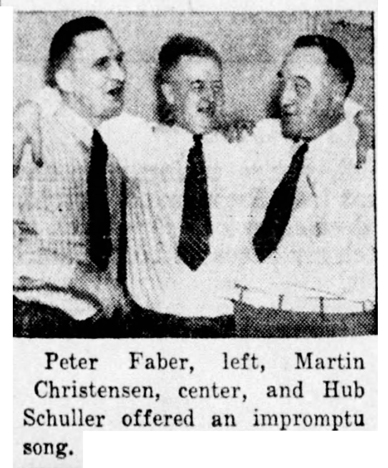
Minneapolis Tribune
The building at 1030 LaSalle Ave. in Minneapolis was built in 1904 as a 48 x 100 ft. brick block for stores. An early use was a laundry/dry cleaner/”dye house.” In 1967 the first floor was remodeled into a restaurant/bar.
Music venues here included:
- Scotch Mist
- f. david’s
SCOTCH MIST
The Scotch Mist Lounge opened around October 1, 1967. One of Wikipedia’s definitions of Scotch Mist is “drunken confusion,” which might explain the 1962 song by that name by a local group called the Scotsmen.
Anyway, Don Morrison of the Minneapolis Star reported that after two weeks the place was packed with kids dancing to the tuned of the Four-Fifths. “The decor is modishly Mod, the music is madly Mod, the lights are low, the drinks reasonable, the scene spirited and the girls as groovy-looking a gaggle of chicks as these tired old eyes have ogled in a long time.”
The owner was John J. Anzevino, Jr., who had co-owned The Office.
In February 1968 there were two lingerie shows on weekdays, and music by the band Four/Fifths: “Where it’s Happening!”
June 1969: The Boiling Point, David and the Mark IV.
There was a fire on July 1, 1970, causing damages of about $75,000, and Anzevino was charged with arson and defrauding seven insurance companies. After the prosecution’s case the judge threw the case out.
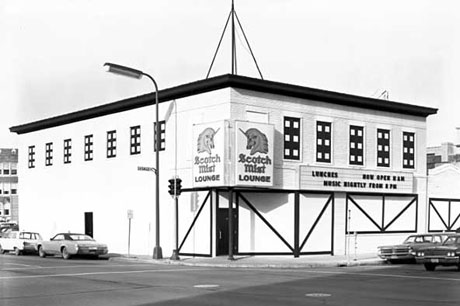
Scotch Mist 1967, photo courtesy Minnesota Historical Society
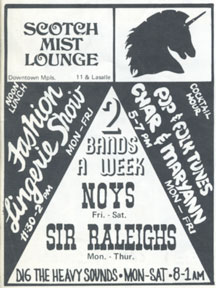
Ad from Insider, April 1970
F. DAVID’S
Frank David Yarusso bought and renovated the Scotch Mist and opened it as f. david’s, a singles bar, on October 13, 1971.
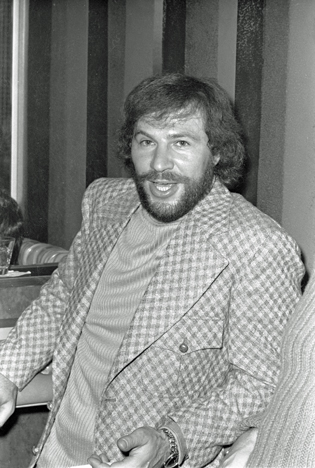
Frank David Yarusso. Photo copyright Mike Barich, St. Paul
Photographer Mike Barich was on hand for the Grand Opening, catching shots of luminaries:
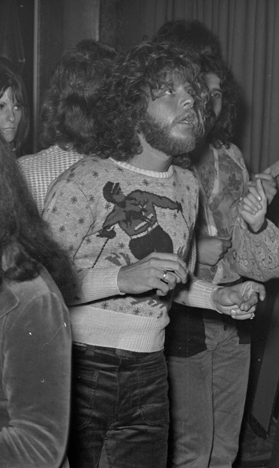
Marsh Edelstein. Photo copyright Mike Barich, St. Paul
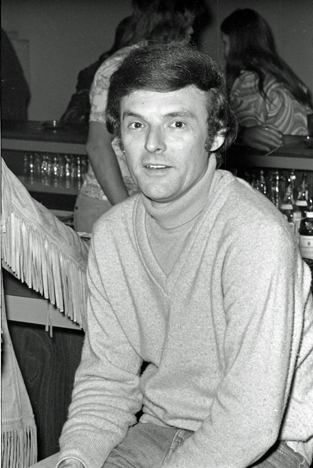
Jimmy Reed. Photo copyright Mike Barich, St. Paul
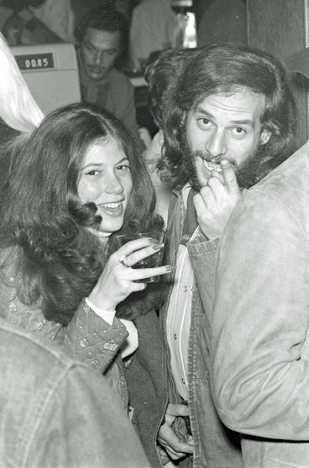
Future Superproducer David Rivkin. Photo copyright Mike Barich, St. Paul
Brave New World was the first house band, initially from October to December 1971.
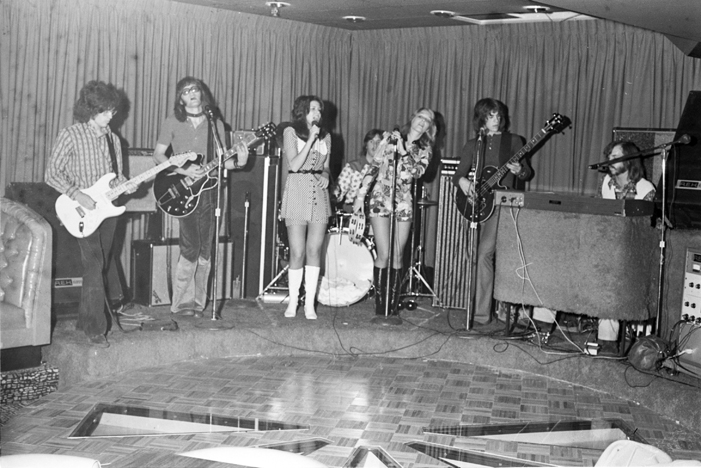
Brave New World, dance floor. Photo copyright Mike Barich, St. Paul
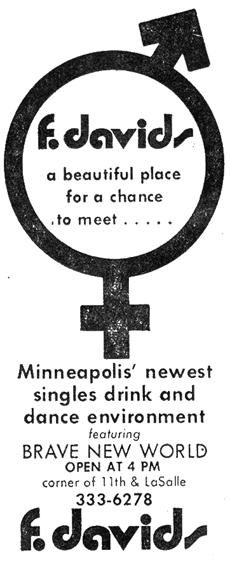
1971 ad courtesy Robb Henry
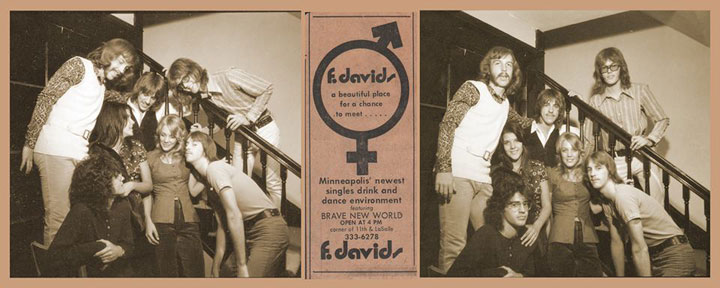
1971 – Robb Henry sitting at lower left
In December 1971, an ad said that Yarusso’s famous Italian food was being served at f. david’s.
In February 1972, bands changed; there are ads for Blue Bird, Pride and Joy, and Open Rhode featuring Connie Olson.
On February 13, 1972, Bill Haley and His Comets paid a visit to f. david’s. Three days later they performed at Coffman Union at the U of M.
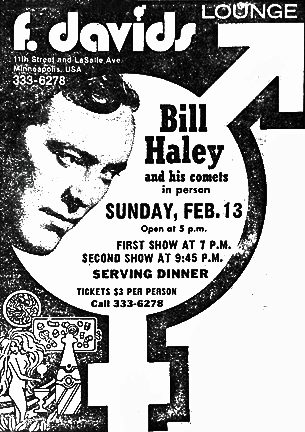
Pioneer Press ad courtesy Jim Froehlich
In March 1972, the slow nights of Mondays and Tuesdays were turned over to disco nights.
On April 29,1972, the Valdons appeared at the club.
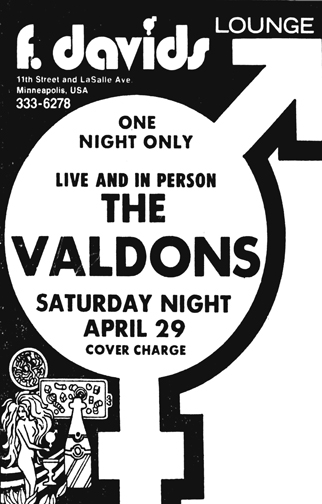
Minneapolis Star, 1972
On June 6, 1972, the Star’s Barbara Flanagan reported that the building had been painted “mustard with black trim,” and she said it “looked good.”
Popular local band Cain stayed a week in July – August 1972.
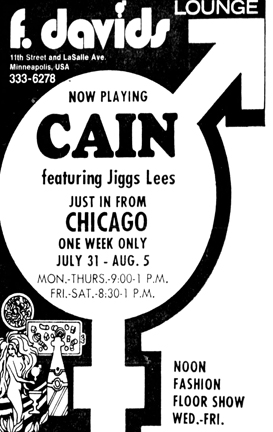
Minneapolis Tribune, 1972
Columnist Irv Letovsky reported that the club was losing money with local groups, so Yarusso starting a new policy of bringing in national acts, starting with pianist Bobby Whitlock in early September 1972. Whitlock had worked with Delaney and Bonnie, Derek and the Dominoes, George Harrison, the Rolling Stones, and Eric Clapton. Despite the weekday gig, Letovsky reported that Whitlock “packed ’em in.”
England Dan and John Ford Coley were booked for October 9, 1972. Yarusso was looking at other national acts such as the Mob, Dan Hicks and His Hot Licks, and Tiny Alice 6 and a Girl. I had to Google that one. (Minneapolis Tribune, October 2, 1972)
Bobby Hatfield of the Righteous Brothers came for a week starting October 16, 1972.
Dakota, Tiny Alice, and Stash were bands that appeared at the end of 1972 and into ’73. The ad below is also a want ad for topless waitresses.
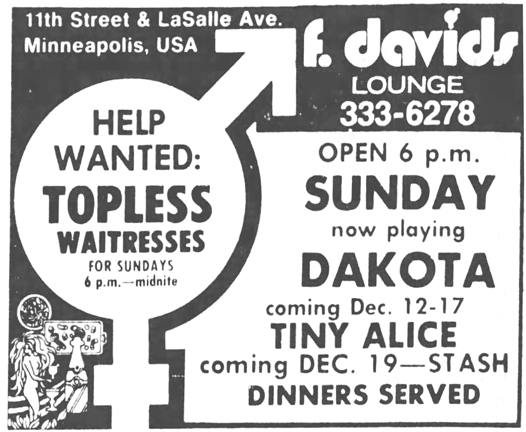
Also featured were lingerie shows at noon Tuesdays through Fridays and during happy hour Wednesdays through Fridays. An article on such shows reported that the businessmen who ate lunch at f. david’s tried to look their waitresses in the eye. Businesswomen (or any other women) were almost nonexistent.
Local groups Sterling and Open Rhode entertained in July 1973, as well as a guitar player named Miguel.
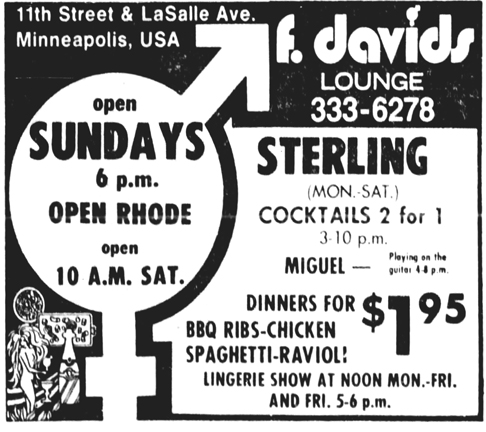
Minneapolis Tribune, July 15, 1973
Although f. david’s was still listed in the Insider in 1974, the club apparently folded in 1973. The building at that location now belongs to the University of St. Thomas and was built in 2005.
Save
Seventh Street Rec, also known as Highland Rec, was located at 1209 W. 7th Street in St. Paul.
See Stransky’s.
Shakey’s was a Pizza Parlor more than a music venue, but one of its distinctive characteristics was its old-time banjo and honky-tonk piano that you could clap your hands to – if your hands weren’t all gooey with pizza. Words to songs were projected on a screen so you could sing along – if your mouth wasn’t too gooey with pizza.
SHAKEY’S HISTORY
From Wikipedia:
Shakey’s Pizza was founded in Sacramento on April 30, 1954, by Sherwood “Shakey” Johnson and Ed Plummer. Johnson’s nickname resulted from nerve damage following a bout of malaria suffered during World War II.
Shakey personally played Dixieland jazz piano to entertain patrons, also hiring the original members of the Silver Dollar Jazz Band, paying the musicians $10 each plus all the beer and pizza they wanted. (Shakey soon realized it was cheaper to pay the musicians scale). Shakey Johnson is honored in the American Banjo Museum in Oklahoma City for his longtime use of banjo music at his pizza parlors. Other live music, including piano, was also a staple in the old Shakey’s parlors. Up until the early 1970s, printed menus included lyrics to classic barbershop songs so that the customers could sing along with the band while their meals were being prepared.
SHAKEY’S IN MINNESOTA
The first Shakey’s in the area opened on August 8, 1964, at 500 E. 78th Street in Richfield (North of 494 near Portland). The franchise was opened by Richard Lupu, who owned 11 of 17 Minnesota franchises.
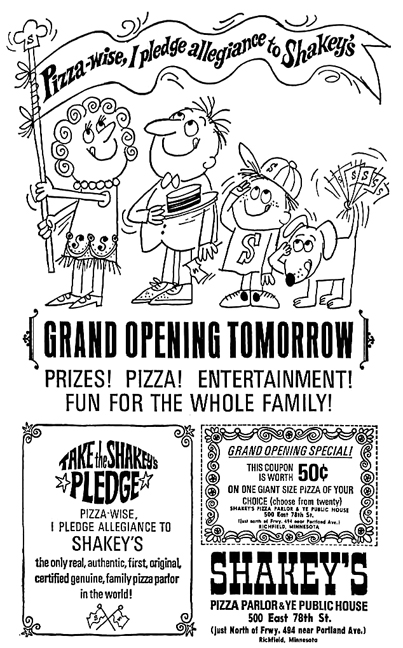
Minneapolis Tribune, August 7, 1964
Unfortunately, on the grand opening, the pizza-making equipment had not yet arrived, so all the place could serve was beer.
In his entertainment column, Will Jones reviewed the new facility:
The pizza served at [Shakey’s] is no better than the pizza at a lot of other places. But the patented, franchised fake pub atmosphere and merchandising that surround the place are fun. It’s sort of the Uncle John’s of pizzadom.
The pizzas are rolled and baked in full view beyond big picture windows, in a kitchen complete with such Shakey’s touches as refrigerators labeled ICEA BOXA.
The cigarette machine is encased in wood paneling and is labeled, “Ye Olde Fags.” [So many anachronisms there..] The walls are loaded with signs like “Shakey made a deal with the bank. Shakey doesn’t cash checks. The bank doesn’t make pizza.”
Customers sit on low, sturdy wood stools at long, low community tables of dark wood, and fetch their own pizza and beer. Light and dark domestic beers and one light German import are available either by stein or by pitcher. There’s a large public room for adults and the children who come with them; there’s a separate beerless room for unaccompanied teenagers. At night a banjo-and-piano duo entertains in the larger room. (Minneapolis Tribune, August 17, 1964)
By 1965, Shakey’s was advertising 21 different varieties of pizza. Most ads were pretty dull, but this one was fun – if you can read it!
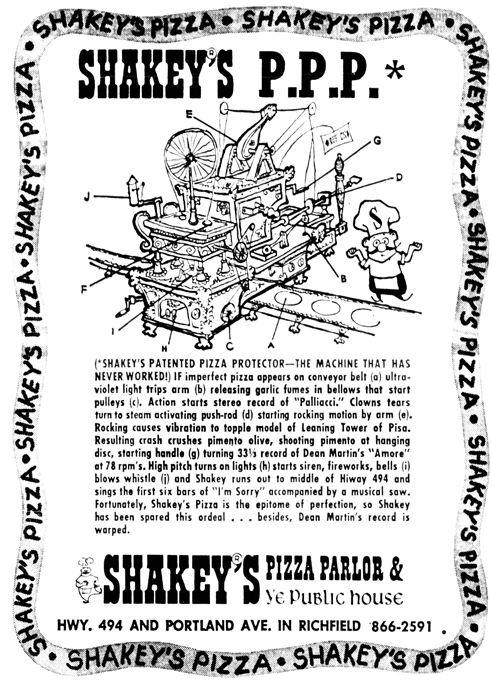
Minneapolis Star, October 14, 1965
STEWS AND VIKINGS
Shakey’s was featured in a piece about area pizza parlors in the Sunday Picture Magazine (Minneapolis Tribune, October 17, 1965). It mentioned that pasta was also available. It also promised sightings of “real live Twins, Vikings and airline stewardesses,” due to the Richfield location’s proximity to the airport and Met Stadium. Pictured in the Picture Magazine were two Northwest Airlines Stewardesses and Vikings Mike Tilleman and Frank McClendon. Shakey’s was also popular with the young people who populated the many apartment buildings in the area.
Also shown were Don Lunning on the banjo and Glenn (Brandy) Brandenburg at the brass tack piano.
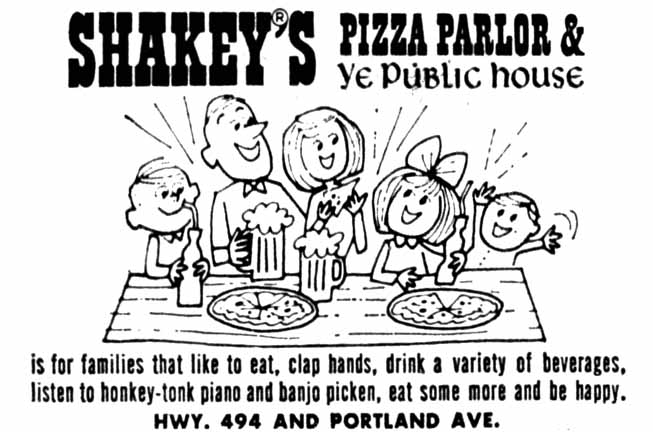
June 9, 1966
STOP THE MUSIC
With more competition, the format changed, and the banjos and pianos were out in 1975.
The ad below has no date, but note that the music is gone. Local Twin Cities locations listed are:
- Minneapolis (U of M Campus)
- St. Paul
- Burnsville
- West St. Paul
- Richfield
- Columbia Heights
- Minnetonka (building built in 1972)
- Falcon Heights (until 1990)
- St. Louis Park (Service Road of now 394)
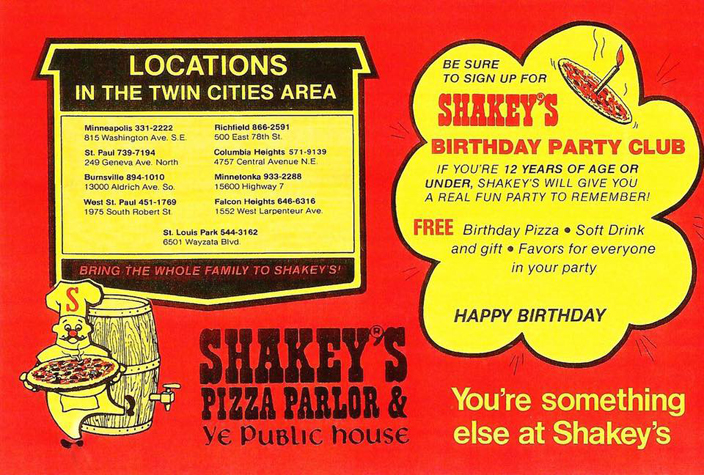
STOP THE SHAKEY’S
One by one, the 17 Shakey’s franchises in Minnesota began to disappear. The last one to close in the Metro was the first one opened: Richfield. By 1990, the only Shakey’s left in Minnesota was in Rochester, which was still there in 2002.
This page purports to tell the history of the music venues at 1528 University Ave. NE, in Minneapolis. They include:
- Denny’s and Don’s Saloon and Restaurant (@1970 to 1973)
- Sun Saloon and Restaurant (@1974 to 2000)
- Shaw’s Bar and Grill (2000 to present)
Although Shaw’s started up 25 years after my cutoff year of 1975, the building had predecessors that had live music before that magic year, so here we go! I’m naming this page Shaw’s, since it’s the best-known of the many many inhabitants of the building.
To trace those inhabitants of 1528 University Ave. NE, in Minneapolis, I used my usual resources (newspapers, inspection and permit cards). Bill Roy also did some digging, and posted a list on Facebook. If I could verify the listing, I gave the primary source. If not, I give the source as Bill Roy. I thank Mr. Roy for his assistance, as well as everyone on Facebook who provided information for this page. It’s not too late to provide more or better information; please Contact Me to provide additions or corrections.
BUILDING HISTORY
The building was erected in 1901 by the Schlitz Brewing Company. It is a two-story brick store and apartment measuring 22 x 55, built at a cost of $4,000. S.J. Bowler was the Architect.
SALOON
It was a “tied” saloon, which meant that it only sold Schlitz beer. Proprietors changed fairly often:
Ignatius Minczac: May 14, 1901 (Minneapolis Times)
Perlick & Skochinski Saloon: 1904 (Bill Roy)
(John) Pearson and Johnson Saloon: May 18, 1904 (Minneapolis Journal)
A.K. Dahlberg Saloon: 1905 (Bill Roy)
Henry Holmes: 1905. Holmes was fined $45 and lost his license in July 1906 for selling liquor on a Sunday (Minneapolis Journal)
Holmes and Dahlberg Saloon: 1906 (Bill Roy)
Frank Grill Saloon: 1907 (Bill Roy)
Dark: 1908 (Bill Roy)
B.S. Weinstein Dry Goods: 1909 (Bill Roy)
Patterson & Weinstein Dry Goods: 1910 (Bill Roy)
W.J. Patterson Dry Goods: 1911 (Bill Roy)
Louis Brezenski Saloon: 1912 (Bill Roy)
Louis Brezelski’s (sic) Saloon: May 14, 1915, Minneapolis Tribune
Brezenski & Schutta Soft Drinks: 1919, (Bill Roy) The only Schutta found was a Deputy Sheriff, with no mention of a soft drink bar.
Edward Loskowski’s Drinkshop: 1920 – 1923 (Bill Roy)
PROHIBITION
Prohibition began on January 17, 1920, when the Volstead Act went into effect. For a space built specifically to dispense alcohol, this was particularly devastating, and “Drinkshop” owner Edward Loskowski may not have taken it seriously enough. From the April 1, 1922, Minneapolis Tribune:
Hose Leads to Moonshine – A drainage hose found by federal agents at the baseboard of an ice box in the drink shop of Edward Loskowski, 1528 University Ave., yesterday led them to a 10-gallon can built in the ice chest wall. Five gallons of moonshine were found in the can. Loskowski was placed in the city jail.
Dark: 1924-1926 (Bill Roy)
John Legut Grocery and Meats: 1927 – 1933 (Bill Roy)
John Legut, Meat Market: July 27, 1929, Minneapolis Tribune
John Legut hit a 67-year-old man with his car: June 23, 1930, Minneapolis Tribune
Billiard Parlor sold cheap. 4 pool tables and equipment. See John Legut, 1528 University Ave. NE (May not actually be at this site) July 21 to August 18, 1930, Minneapolis Tribune
REPEAL
The first step in repealing Prohibition came on April 7, 1933, when 3.2 beer and similarly low-alcohol wine became legal for the first time. John Legut got one of the first 3.2 liquor licenses in Minneapolis in 1933. (Minneapolis Tribune)
Legut was fined $100 for selling beer after hours – the City Council threatened to take all of his licenses away, but apparently they didn’t do it. August 1934, Minneapolis Tribune
John Zyck came on the scene in February 1936. He may have taken over the liquor license, although the building seems to have still belonged to Legut and the bar was still called Legut’s.
Legut’s, John A. Zyck, Prop. Found slot machines, March 1938. Minneapolis Tribune
The bar was for sale in May 1938. Minneapolis Tribune
Legut built a 1-story addition costing $700, April 1939.
Legut again listed the building for sale in April 1940: Minneapolis Tribune
B & B BAR AND CAFE
The building hosted the B & B Bar from about January 13, 1942 to June 1970, although it could have been earlier and later.
The B and B were Julian Boyda and Daniel Bucknok
Air Conditioning was installed in 1948.
On February 15, 1965, Frank Boyda was the Manager.
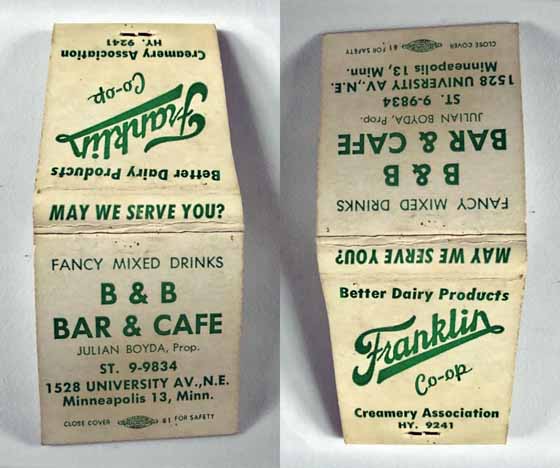
Matchbook images courtesy Bill Roy
DENNY’S AND DON’S SALOON AND RESTAURANT
Denny was Dennis Sazenski (who later owned Thumper’s and Peabody’s, according to his obituary.) This was a Cowboy Bar that closed in about August 1973. Denny died in 2012.
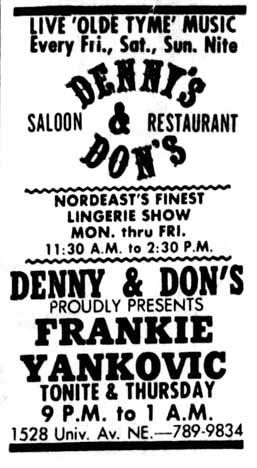
Minneapolis Star, November 29, 1972
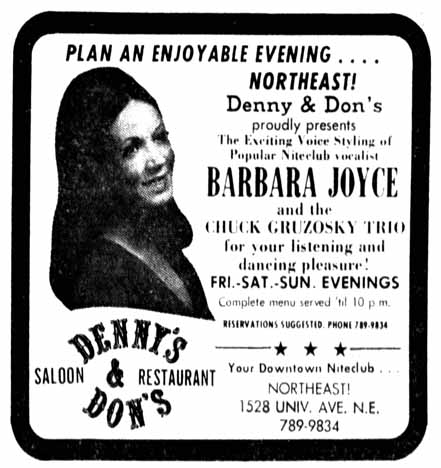
Minneapolis Star, February 23, 1973
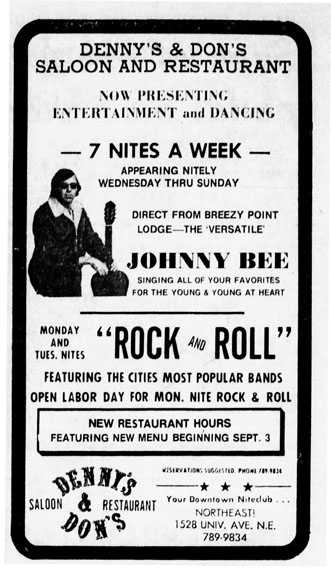
Minneapolis Star, August 31, 1973
SUN SALOON AND RESTAURANT
This new iteration opened on or about July 4, 1974. This was the same year that Patrol Limits were finally abolished from the City of Minneapolis. Patrol Limits, dating back to 1884, limited the geographical areas where people could establish liquor bars (vs. 3.2 bars) in the City of Minneapolis. They were basically limited to Skid Row, the Near North Side, and Northeast.
An article in 1991 said there were then 34 bars in Northeast vs. five in South Minneapolis. The Sun Saloon attracted “hardcore bikers.” (Minneapolis Star Tribune, March 25, 1991)
SHAW’S BAR AND GRILL
Michael Shaw took possession of the bar from John McGuire at midnight on April 1, 2000.
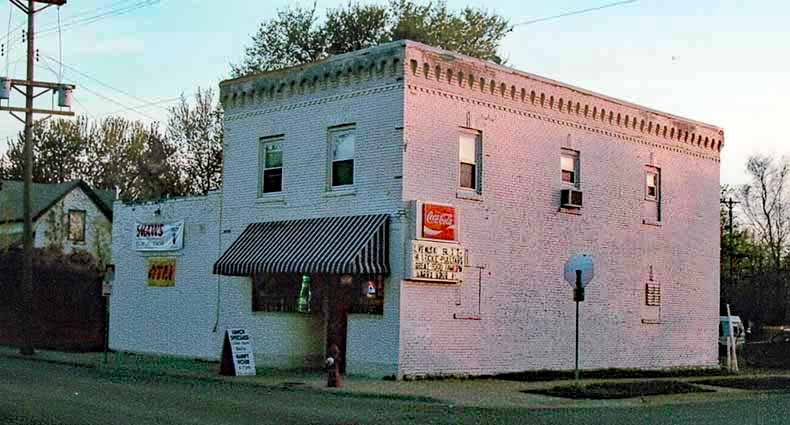
Shaw’s, 2000
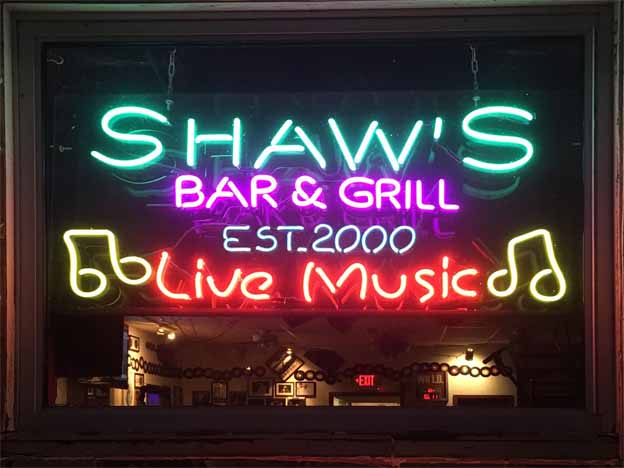
See the Bull Pen
THE SHERATON RITZ HOTEL
The Sheraton Ritz Hotel was located at was then 315 Nicollet Ave. (It became Nicollet Mall in 1974.) It took up a City block bounded by Nicollet Mall, Marquette Ave, and Third and Fourth Streets.
BEFORE THE RITZ
The hotel was built on the ashes of buildings cleared for the Gateway District Urban Renewal Project:
309 – 307 Nicollet consisted of one, three, and four story brick store and office buildings, demolished in April 1961.
311 – 329 Nicollet, including 32 – 44 So. Fourth Street and 331 Nicollet, was collectively known as the Palace Building. It consisted of three four-story buildings, two eight-story buildings, and a nine story brick store and office building. They were demolished from May to August 1961.
CONSTRUCTION
The hotel was the first major structure built after the clearing of the Gateway. The building permit was taken out on April 23, 1962, and the cost listed was $5,631,000. James Lileks wrote that it was the first big hotel built downtown since the 1920s. The hotel opened to the public in 1963. The 17-story hotel had 305 air-conditioned rooms.
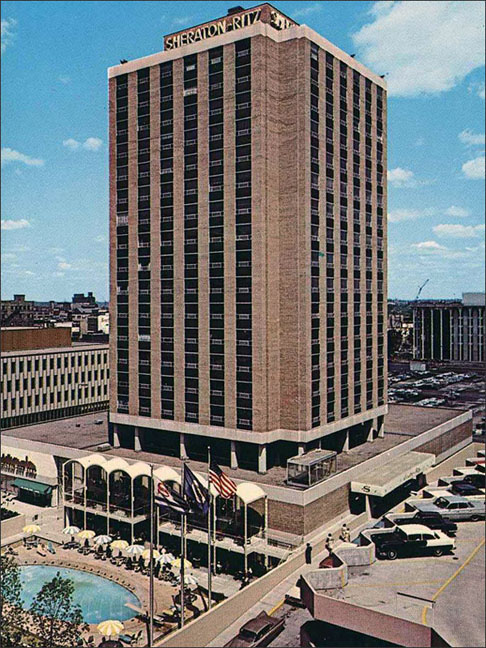
1963 Postcard courtesy of the Hennepin County Library Special Collections postcard collection
FEATURES
The hotel itself was done in the 1960s modern style with a white marble lobby and chrome metal accents and fixtures. The ground level of the hotel featured a plaza and shopping arcade, including the International Design Center, an importer of Scandinavian home furnishings.
The still below from one of the Route 66 episodes shows that, although the hotel was supposed to be Jetsons modern, the rooms were quite busy and frilly, as James Lileks pointed out. An ad on June 3, 1963 explains that Sheraton Ritz architect-designer Mary Morrison Kennedy designed the top seven floors in French Provincial, with Louis XVI furniture, with deep pile carpeting, and “shimmering crystal chandeliers, reminiscent of the palace at Versailles.” (Minneapolis Star, June 3, 1963)
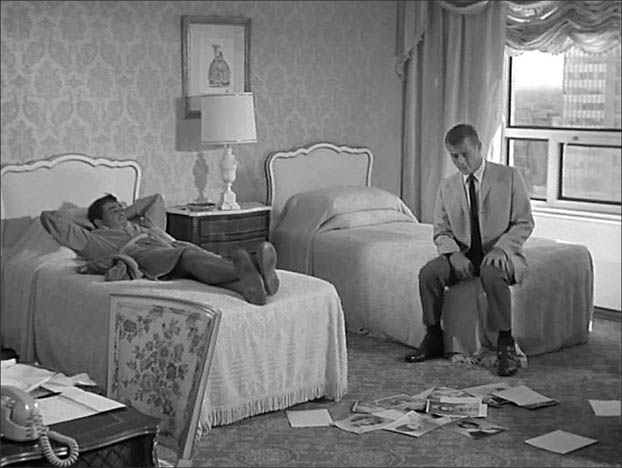
Image courtesy James Lileks
The swimming pool was constructed so that it could be converted into an ice skating rink in the winter.
In 1963, the hotel was featured in three episodes of the 1960s television series Route 66.
During its lifetime it counted as guests at least two U.S. presidents and celebrities Bob Hope, Henry Fonda, and Ed Sullivan.
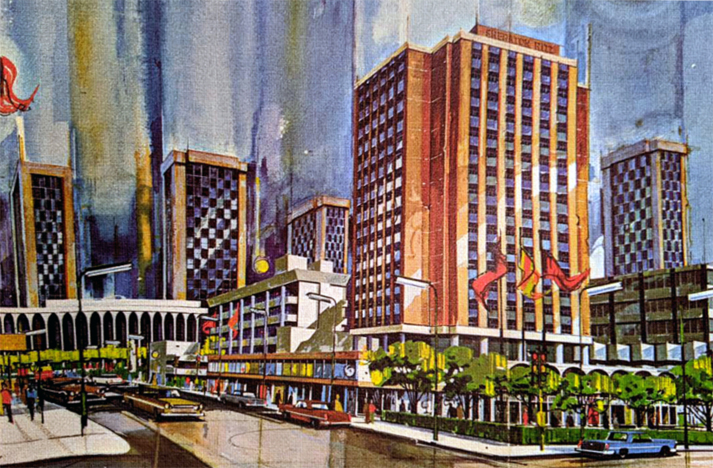
Image from the Nokohama website
VENUES IN THE HOTEL
LA BRASSERIE
The other restaurant was called La Brasserie, described as a “coffeehouse with la haute cuisine,” which opened on June 3, 1963. The atmosphere was “a light-hearted, chic copy of Paris in the Gay Nineties.” (Where magazine, April 20, 1968)
THE CHESHIRE CHEESE ROOM
The main dining room was called the Cheshire Cheese Room, which opened June 17, 1963. A description in the September 1974 issue of Where magazine mentioned “wooden beams and paneling, red and black table linens, stained glass panels, copper kettles and candle chandeliers, which help to recreate an Elizabethan atmosphere.” Wait staff dressed in colorful, Elizabethan costumes. This is where you could get a yard of ale served in a wooden stand. Our waitress memorized the orders of 13 people, most of whom changed their potato order.
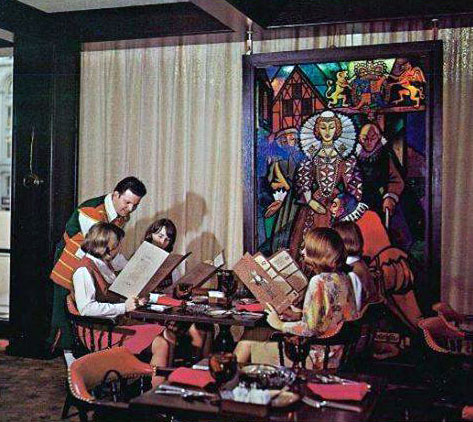
Image of the Cheshire Cheese Room from the 1965 St. Louis Park Echowan Yearbook
THE GOLLIWOG LOUNGE
The Golliwog Lounge opened on May 31, 1963. This was the first room to open, even before the hotel itself. It is unclear where the original location of the Golliwog was, but given that there were entrances from the street and from the hotel, it may have been on the first floor.
The room “features a leggy breed of waitresses known as the Golliwog Girls” who wore brief costumes and wild hats. On opening day the costumes weren’t ready, so the waitresses just wore something that was “merely brief,” reported Will Jones.
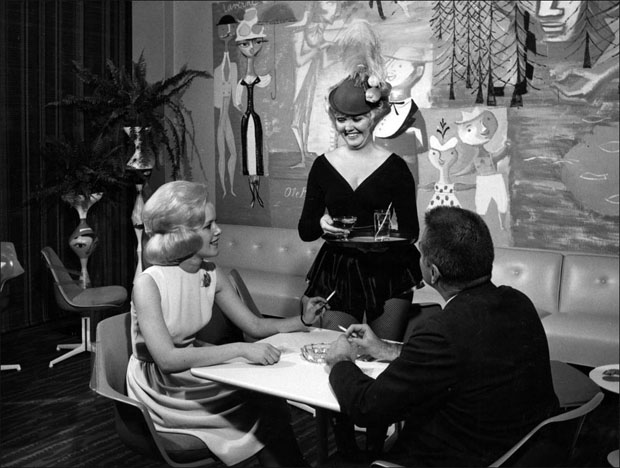
Image from James Lileks
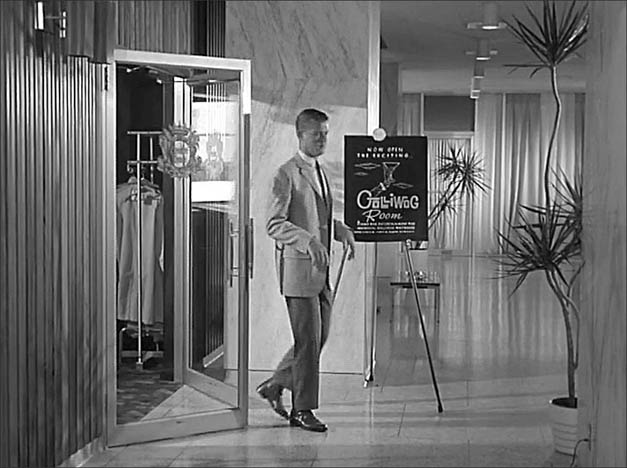
The venue was called the Golliwog Room on Route 66. Image from James Lileks
The first ad for the Golliwog promised a piano bar with Hal Cooke at the Keys, June 8, 1963.
The Golliwog reopened on the 19th Floor on January 17, 1964. Jazz artist the Bill Samuels Trio was the entertainment. General Manager Charles T. Carey placed an ad apologizing that hundreds had to be turned away on January 17 and 18, 1964. The room only held 120 people. (Minneapolis Star, January 22, 1964)
A popular performer at the Golliwog was Doris Hines. Three Keyes. September 1965. Review by Allan Holbert Trib September 22, 1965 – December 28. November 1, 1966 – December 15
Kay Nygaard
In April 1966, a space that was left empty on the 19th Floor during construction was used to expand the Golliwog Lounge and build 16 more suites and rooms.
From March 13 to 18, 1967, the Golliwog booked Chad Mitchell, late of the Chad Mitchell Trio, as part of a new policy of big name entertainment. (Allan Holbert, Minneapolis Tribune, February 19, 1967) Mitchell got excellent reviews from both Will Jones of the Tribune and Don Morrison of the Star. This was also a first departure from jazz for the Golliwog.
A 1968 ad promised no cover, no minimum, no dull moments.
A July 1969 ad named Stanley Stein as the host.
John Denver did his perhaps first solo gig here between May 12 and June 1, 1969.

Minneapolis Tribune, May 12, 1969
THE RITZ BAR
The Ritz Bar, at 318 Marquette, opened on March 17, 1964. Oh my. I quote:
Now at last, in a world of feminine frippery, the Sheraton-Ritz offers a haven for the harried male. The new Ritz Bar, on the Marquette Avenue street level (beneath the parking ramp) is open to men only from 11:00 AM to 8:00 PM Monday through Friday.
The Ritz Bar is Frankly and forthrightly a man’s saloon, true to the fine old tradition. Here the stag can drink his fill amidt good talk and good fellowship, free from the distractions of the opposite gender. A cold English buffet provides hearty masculine fare.
Special note to Wives and Sweethearts: Dear ladies, for diversion a deux, we offer the many splendors of La Brasserie, the Cheshire Cheese, the Golliwog Lounge. But please do not ask your escort to take you to the new Ritz Bar. There he goes alone, a man among men. But his absence from your side may well make his heart grow fonder.
(Minneapolis Star, March 17, 1964)
On March 18, Will Jones minced no words when he wrote that he found the men-only policy “repugnant.” He wrote that there were already places in Minneapolis that were self-segregated, and they tended to be drab and uninteresting. There was no need to advertise a men-only policy in a world that was fighting segregation. He talked to a bar designer whose theory was to decorate a manly-type bar that would attract men, with the intent that women would come to meet the men, and the men would come to meet the women. It worked.
On June 1, 1965, Will Jones announced that the Ritz Bar would reopen that day as a “heterosexual bar.” In December 1965, Rhys Evans held forth at the piano bar in the Back Room at the Ritz Bar.
The last ad seen for the Ritz Bar is in 1968.
SADIE’S PARLOUR
Sadie’s Parlour was located on the 19th Floor of the Hotel, and had a Roaring Twenties motif. High-backed throne chairs are arrange for an intimate twosome, while low chairs and booths accommodate small or larger groups. (Where magazine, September 1974)
DEMOLITION OF THE SHERATON RITZ
During the mid-1980s the hotel changed hands several times and later operated under the names of the Minneapolis Plaza Hotel and the Minneapolis Ritz. It was closed on July 1, 1988, just 25 years after opening, citing a lack of business. It was demolished in 1990.
During the early 1990s, various proposals for use of the space have circulated, but the old address of 315 Nicollet, which is now half the block, has only been used as storage, temporary event space and parking. The other half of the block is now 365 Nicollet Mall, where apartments were built in 2017.
Information for this section was researched and written by Central Library Special Collections volunteer Nick Steffel. Also see James Lileks series.
The Sherwood Supper Club was at 7th and Auditorium, St. Paul.
On February 22, 1963, Will Jones noted that it had been open for some weeks and used to be Johnny Mauer’s Recreation, with a bowling alley run by Jake and Hank Mauer.
More Jones:
The interior is old English, like in Sherwood forest, with a big tree in the middle of the main dining room, the exteriors of low-slung ivy-colored cottages suggested about the walls, and shields and heraldic stuff, and the Irv Williams Quartet playing on a bandstand that is fixed up like a drawbridge.
The Sherwood featured jazz in its main room, and Jones noted that they were planning a downstairs room called The Cave. Ad below from the June 1963 Twin Citian.
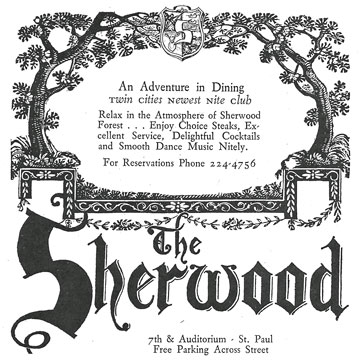
Save
1963 ad just says Willernie, close to White Bear Lake. Attractive supper club with piano bar, oceanic atmosphere.
The Shoreview Roller Rink was located on the northwest corner of Hodgson Road and Highway 96. Bill Diehl hosted the Trashmen here.
Shorewood Lounge was by Moore Lake, North of Central Ave., on the east side of the highway.
Please see Whiskey Go Go
Shuffletown was a local youth center located in the Citizens Aid Building, 404 So. 8th Street, Minneapolis.
The building was built in 1928 and later housed the Greater Twin Cities United Way.
In the 1940s, kids from Minneapolis high schools would dance to Big Bands, including that of Bruce Dybvig, which was often referred to in news reports as the Shuffletown band. His band played there every Friday night from 1944 to 1946.
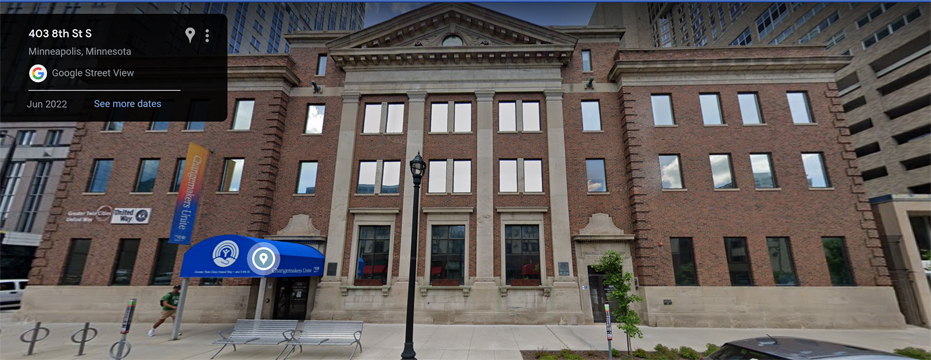
The Silver Bar was in Hopkins, one of thousands of joints that opened up once beer was deemed “non-intoxicating” on April 7, 1933, before the outright repeal of Prohibition, and before the requirement that taverns had to have permits.
The reason I know about this is that Rudy Shogran, the operator of the Excelsior Park Ballroom, went to investigate why attendance was down during the summer of 1933. Rudy left detailed journals with notes for every day that the ballroom was open.
He wrote about how honky-tonks line Excelsior Blvd. from Excelsior to Hopkins, and how patrons were “drunken, loud, talking, and slopping of beer.”
Disgusting to me, but it sums that is what the people want. The place on Minnetonka Blvd. where they built a little dance floor was crowded to capacity with a three piece band and all the beer you want.
June 15, 1933:
The little joints along the roadway are all doing big business and they are springing up like mushrooms everywhere, including fee dance floor with your nickle glass of beer.
July 8, 1933:
Crowds are all in the honky tonks along the route to Hopkins, and a little place hear the Park has an outdoor dance place crowded with two n****r players free dancing and beer 5 cents… Hopkins is crowded with their joints hope it will soon blow over this craze for a wild hectic evening, noisy unlady and ungentlemenlay actions.
July 15, 1933:
The Silver Bar in Hopkins is crowded to capacity – drinking, smoking, yelling, hollering, and two n****rs playing in a small outfit.
No idea where the Silver Bar Cafe was, unfortunately!
The Silver Bridle Bar was located at 929 West Broadway, according to the photo below from the Minnesota Historical Society. The band name is unknown.
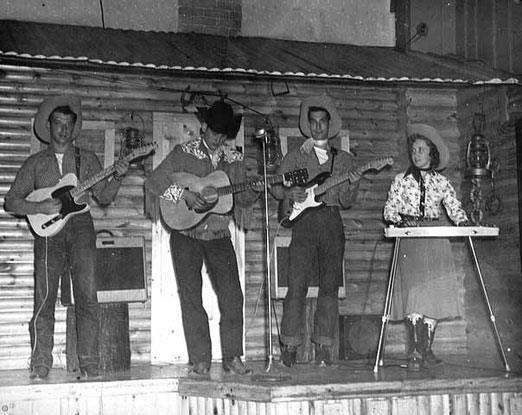
@1950 photo courtesy Minnesota Historical Society
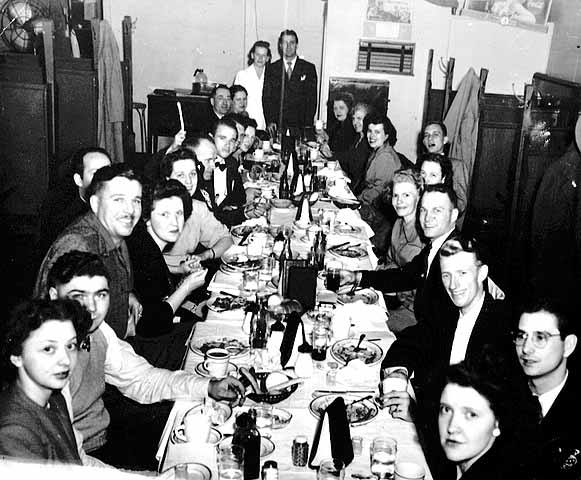
Benefit Dinner at the Silver Bridle @1953-1954, courtesy Minnesota Historical Society
200 E. Lake Street, Minneapolis.
LUNCHROOM: 200 1/2 EAST LAKE
Not sure where in the building this would be, but probably on the ground floor, since it was a lunch counter and bar. License information printed in the paper shows an incredible amount of turnover in ownership.
In 1930, during Prohibition, Ernest T. Kreisel had the lunch counter. In May 1934, he got his license for non-intoxicating malt liquor. Beer had been re-classified as non-intoxicating so that the people’s thirst could be slaked. By October 1, 1935, the restaurant had been taken over by Walter C. Marohn. Next was W.R. McKean in 1936. That didn’t last long: July 1936 was Ida McCormick and Rose Bushey. Paul Larson and Robert Brothen were next in March 1937.
OTHER BUSINESSES
In 1932, the address was the scene of contention, as a family of chimney sweeps argued over listings in the city directory after the firm had broken up.
In May 1932, an Ice House was added to the property. Peter Jensen operated it in July 1933.
In 1934, probably from another part of the property, was a auto body repair shop
PHIL’S TAVERN
In September 1940, Phil’s Tavern offered food, bowling, and dancing.
PHIL’S BLUE ANGEL ROOM
In December 1960 we see the first ad for the Blue Angel Room, featuring Augie Garcia.
A February 1961 article in Select Magazine tells us of a performance by Augie at Phil’s.
An ad from May 1962 is for Augie at the Blue Angel Room.
Stebbins reports that Phil’s Blue Angel tried jazz but switched to country-western. (before 1964).
I don’t know what the item below actually is, but it came from the collection of Mark Youngblood.


SILVER DOLLAR CLUB
Hans P. Hanson opened this dance hall on January 24, 1964. The building included two bars, a huge ballroom, and two 2-bedroom apartments.
It appears that Dixieland was the first genre that was featured when the club opened.
It was a country western venue by April 1967.
On November 25, 1970, there was an ad that the building had to be sold because the owner had had a heart attack. These ads continued until May 1971.
SILVER DOLLAR II
In November 1971 Charlie Campbell/Community News converted the Country bar to rock and blues.
Mark Peterson described it:
A 3.2 beer establishment, it had three bars, two stages and a big dance floor, and even a diner/coffee shop under one roof. There was music nearly every night of the week.
In an email dated June 17, 2013, Charlie told me:
In the ballroom we presented local blues and R&B bands like Lamont Cranston, Willie and the Bumblebees, the Lake Street Stink Band, Mill City Blues Band, Joel Johnson and others. We also presented Bonnie Raitt, Luther Allison, Charlie Musselwhite, and Muddy Waters in the big room.
Single artists like Lazy Bill Lucas, Dave ‘Snaker’ Ray, ‘Spider’ John Koerner, ‘Papa’ John Kolstad, and Tommy Ray performed in the smaller tavern side of the building.
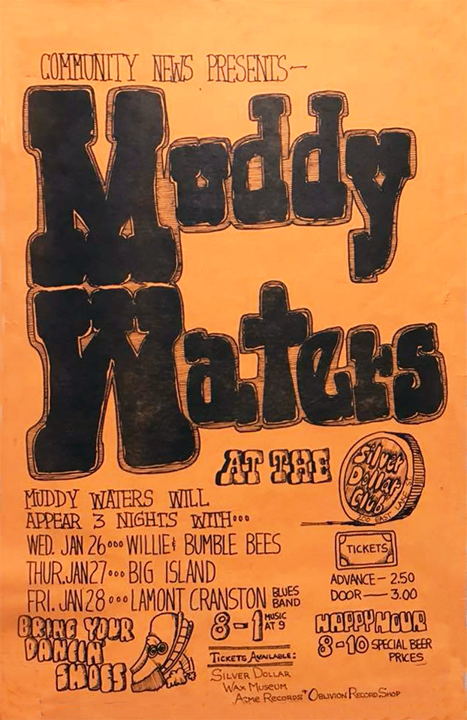
1972 poster – courtesy Johnny Hanson
Charlie says that the venue closed in the summer (May) 1972.
In July 1972 the building was being up for sale by a real estate company.
A permit to demolish the building was issued on February 20, 1973. 210 E. Lake Street is a Mc Donald’s, which, coincidentally was built in 1973. (West of that of that is 35 W, which was built across Lake Street in 1968-1968, so it wasn’t torn down for the freeway.)
North St. Paul
Dale Street, St. Paul
It started when I found this ad in the Minneapolis papers from April 18, 1965.
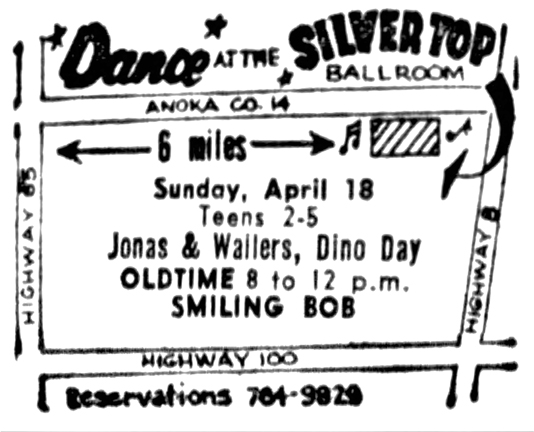
Some notes on the map:
- Anoka County Road 14 is Main Street.
- Highway 100 is 694. At one time a bunch of roads were cobbled together and called Highway 100 to create a “beltline.” It was later replaced by 494/694.
- Highway 8 is now 35W.
- Smiling Bob may be the guy who ran the Friendship Club before it became Mr. Lucky’s. He may have gone on to work at the Burnsville Bowl.
- Dino Day was the host of “A Date With Dino.”
The only other reference I found in the Strib was this ad from March 15, 1965.
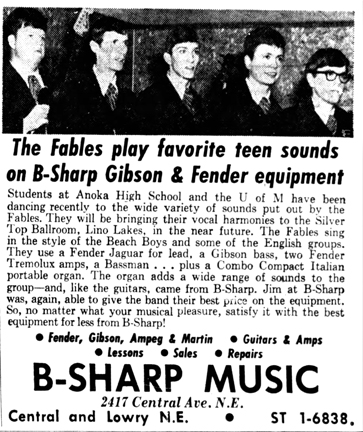
I’d never heard of the place, so I asked about it on Facebook.
Thanks to Henry Feist, we know that the Silvertop Ballroom was located at 566 Main Street in Lino Lakes. This was pretty far from the ‘Cities, but Henry said that “my grandmother used to talk about the long drive out there from St. Paul to attend dances. Evidently, it was a hot place to be at one time.”
THE SILVERTOP LIVES!
The building still stands! We checked it out in the summer of 2019, and by golly, there it was!
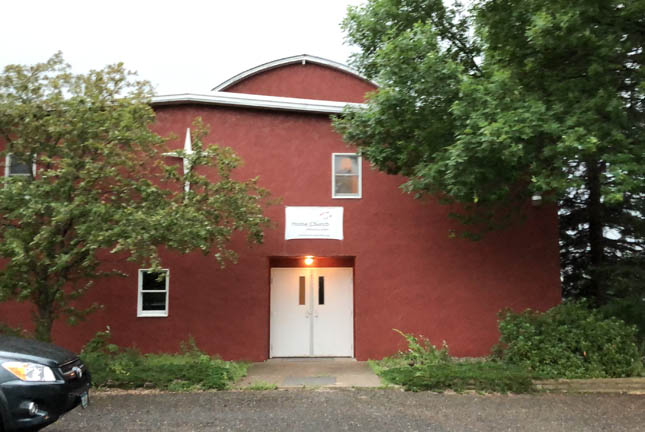
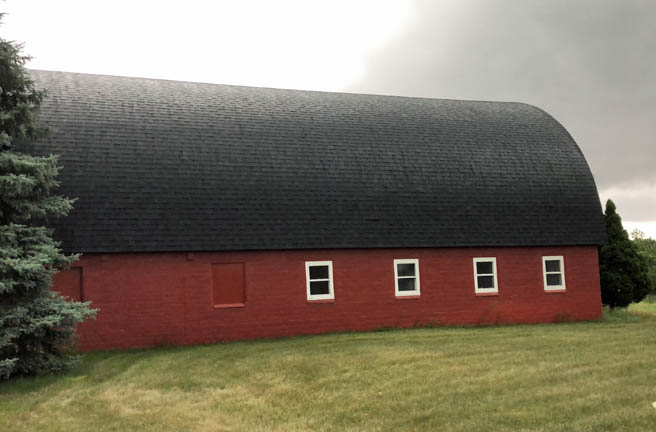
THE BIRTH OF THE SILVERTOP
Well, the Internet is a wonderful thing. The daughter of the man who built the place saw this entry and gave her dad, Richard Lichtscheidl, my phone number. We talked, and he decided that he would write the history of the Silvertop down for me, and don’t you know, he sure did! What follows is Dick’s narrative of how the Silvertop came to be.
It started with a storm in the mid 1940s that blew our old barn down. My dad and us brothers built an outdoor shelter and milked the cows outside. We started building the barn by digging a trench or footing (by hand with four shovels) four feet deep by two feet wide for the cement foundation. Dad hired a bricklayer and I remember mixing the mortar for him for weeks and carrying bricks also.
Most of the lumber came from a lumber mill in Wisconsin. The hayloft, or top floor, was built with boxcar planks from East Bethel, Minnesota, where they sold this heavy lumber. The round roof rafters were brought over in small pieces of lumber and four layers had to be nailed together.
The barn gradually was built with room for 30 cows. Next to it was a milk house and two silos for corn silage.
My mom died in 1949 at the age of 44, and Dad eventually slowed down with farming. Three of my brothers were in the Army, and Dad decided to have an auction, ending his farming days.
I went to work on a wheat farm in Montana from 1952 to 1954. The day I came home, a beautiful girl that I had known for seven years (we had never dated because she wouldn’t) pulled in the driveway. She had seen me in the yard as she “happened” to be driving by. We finally dated the next day, and I gave her my class ring that night. We were married in 1955.
We bought land and built a basement house about 1/2 mile from the farm. In 1960 the old farm house burned to the ground. My dad (now staying busy by selling strawberries on old Highway 8 in Lino Lakes) moved a new house onto the old foundation. My sister lives there to this day.
My wife’s mother died in 1959, leaving her father, Ed Shocinski, alone in Lexington, Minnesota. Eventually, Ed met a woman who loved to dance as much as he did, and they married. Ed talked about making the barn into a ballroom.
So I bought the barn with three acres from my dad and six brothers and sisters. First, I applied for a permit and that went well. Then we removed all the old hay that was about a foot thick. One of the first big projects to do was the septic system. We dug a trench to the west about 100 ft. long – shoveling by hand. Then a large septic tank was installed, and the space it was placed in – again – all shoveled by hand. I hired a well driller who put in a 60 ft. deep well to supply water for the bar and restrooms. The well had a little shelter-type building over it, insulated for the winter months with heat lamps installed. An entrance was built with stairs leading to the upper floor.
Inside, we put down 3/4 inch outdoor plywood as an underlayment for the floor. When inquiring about dance floors, I was told to get maple flooring in planks not more than 18 inches long. I purchased the flooring from Interstate Lumber in Hugo, Minnesota.
The flooring took about a month to nail down by hand. We installed the ten foot tall ceiling, and added a platform for the band by adding a 12 ft. by 20 ft. extension out the south side of the barn. We also added an exit door and back stairs. The dance floor took up most of the barn except the bar was on the north end, next to the two restrooms (three toilets each).
In order to have seating for 300 people, we cut out the east side of the barn and added an area of 20 ft. by 60 ft. adjacent to the dance floor. The floor in this area was tiled. We bought used tables and chairs from a supplier in Minneapolis, and asked a farmer who was was hauling cattle to South St. Paul to pick up a load of the tables and chairs on his way back.
Before finishing the inside, heavy-duty electrical wiring was installed, as well as two furnaces. A large fan was installed on the south end which brought in outside air for cooling on summer dance nights. We used paneling for all the common area walls and sheetrock in the restrooms. The lower level of the barn was left like it was when the cattle were there. In the northwest corner we made a storage area for beer, pop, etc. It took from 1961 to 1963 to finish the ballroom.
My wife, Ursula, got started in getting bands for Saturday and Sunday dances. The first band she booked was the Jolly Brothers, which was really popular. We had hired four waitresses and a bouncer. Ed and myself were bartenders. Ursula bought advertising on the radio and on opening night we filled up quickly with people waiting outside before we opened!
We had good old-time bands like Ray Sands, the Jolly Lumberjacks, Lavern and the Starlites, the Six Fat Dutchmen, etc.
In the fall of 1963 President Kennedy died and that stopped people from dancing for a while. Business picked up quickly after that, however. Ursula was always at the front entrance collecting admission fees and seating people with reservations. She was the most friendly person, and being full-blooded Polish, she fit right in with the Polish-style bands.
Eventually, because of our large family and too much work, we put the Silvertop up for sale. By the way, I was also working full-time night shift at the Hamm’s Brewing Company. Two couples bought the place in 1965: Bob Anderson and his wife and their son and his wife. After one year we were forced to repossess the Silvertop and start over. Within one month everything was back to normal.
In 1968 we wanted to sell again and a man who owned a bar in Minneapolis bought the ballroom and the name became “The Aragon Ballroom.” As much as I can remember, the ballroom was sold one more time and eventually it was bought by The House of Praise Church.
Richard Lichtscheidl, September 19, 2019
ADDENDA
Dick also mentioned that the ballroom was so popular when it opened in 1963 that the Bel-Rae Ballroom was opened nearby in 1964, which cut into their business.
Listings for the Aragon Ballroom run from September 1974 – November 1976.
The Aragon Ballroom is listed for sale in ads from August – December, 1976.
House of Praise – June 1978
New Dawn Ministries: July 1983
The City of Lino Lakes dates the building to 1938.
Skip’s Barbeque was located at 1729 Lyndale Ave. N., as early as 1971.
Ads for help can be found to May 1973.
Curtis J. Metcalf wrote to say that he remembers a basement venue below Skip’s where Flyte Time was playing. As he and his friend sat down in a booth, the band broke into “Play that Funky Music.” This puts the date at 1976, as that’s when the song came out, and before Flyte Time became the Time. My U of M classmate Tom Lund was in Flyte Time, as was Jellybean Johnson.
The Skyway 12 Club was a tavern located at 15017 Wayzata Blvd., just past the intersection of I-394 and 494 on the south side.
The Skyway was there from at least 1961.
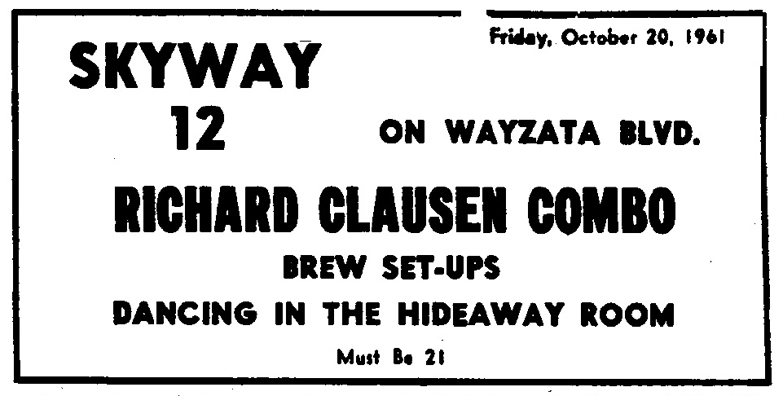
Minnesota Daily, 1961. Ad courtesy Robb Henry
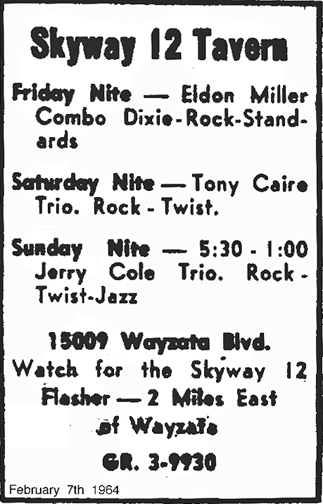
Minnesota Daily, 1964. Ad courtesy Robb Henry
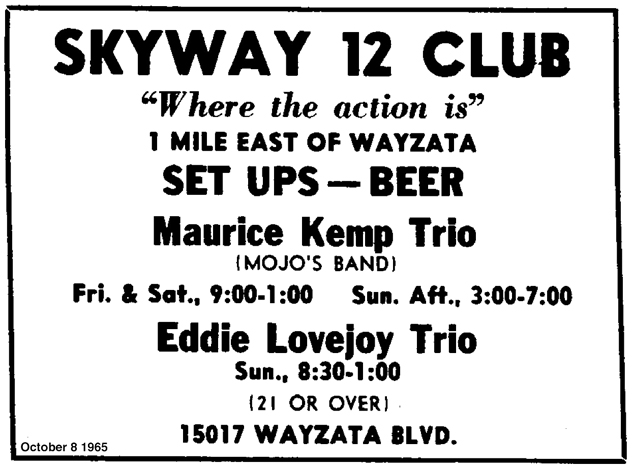
Minnesota Daily, 1965. Ad courtesy Robb Henry
In 1967 it was run by Ben Musser and offered live music on Sunday nights.
On January 29, 1968, tavern buyer Gary Boster got a license to sell 3.2 beer, on and off. The Council was not optimistic: “Do you know how many owners went broke up there? asked Minnetonka councilman Ed Mason. “How do you plan to attract customers when they have to go a half mile out of the way just to get there?”
The Minnetonka Herald (2/8/1968) reported that the tavern sat atop a hill with access only by service roads, none of them leading directly to the tavern. It also sat on residential property and the non-conforming use permit had to be renewed annually and could be revoked if there were complaints. Boster had his sights set on a set-up license in about six months if he was successful. See info on this old roadhouse on Robb Henry’s blog.
The Skyway was abandoned in about 1968. Houses built in 1997 are there now.
Please see Lyceum Theater
This page discusses venues that inhabited the building at 21 So. 8th Street, across from Dayton’s Garage.
These include:
- The Silver Tray Cafe
- Sleizer’s Restaurant/Club 21
- Bowman’s Club 21
- Club 21
- Duff’s
THE BUILDING
The building was actually designated as 800-8016 Lasalle Ave. by the City on its building permit cards, and encompassed many addresses. The first notation for the building is in 1897, for alterations and repairs, so it was obviously built before that time. 21 is always listed as a store and office building. In 1921 it is listed as a shoe store.
In September 1928 and 1932 it is listed as a cafe. This could be DeLyon’s Candy Shop, which also served hot dinners. It was typical to see candy stores, or “confectionaries,” during Prohibition (1920 – 1933). DeLyon’s went bankrupt in September 1932.
SILVER TRAY CAFE
By December 1932 it was the Silver Tray Cafe, where you could dine and dance. The Silver Tray lasted through 1939. Permit cards show that an addition was built in April 1934.
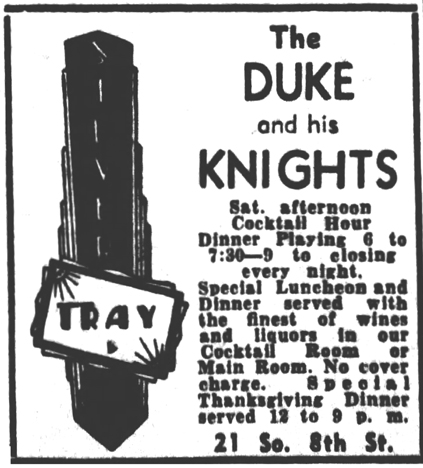
Minneapolis Tribune, November 24, 1934
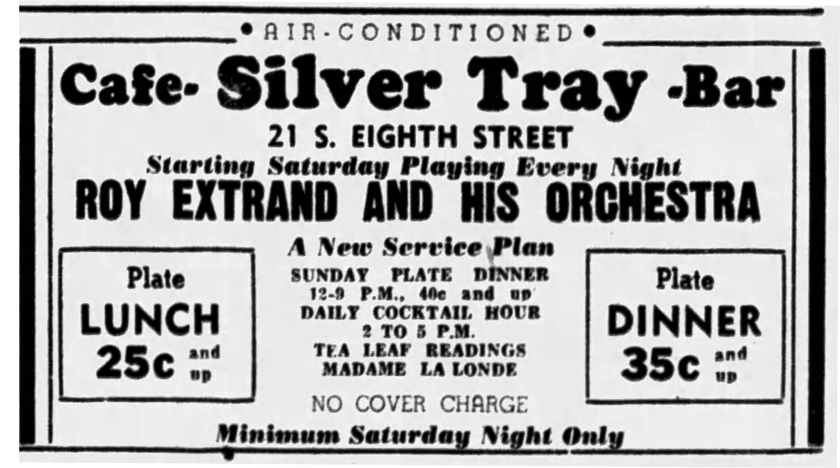
Minneapolis Tribune, September 24, 1938
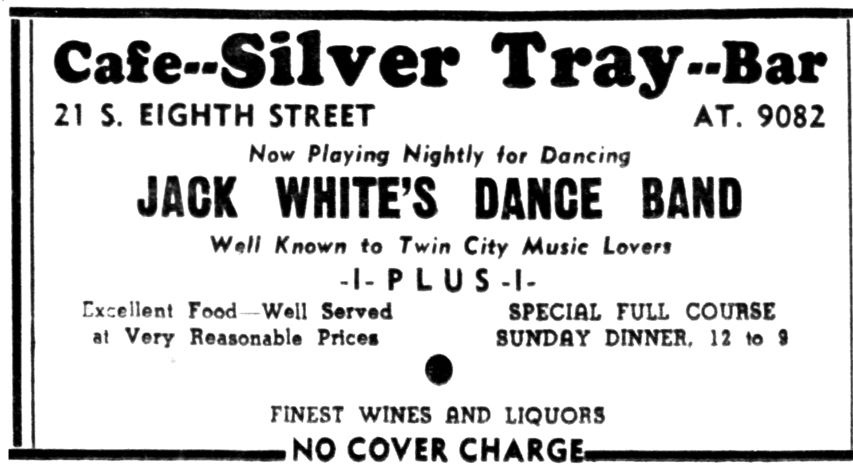
Minneapolis Tribune, November 6, 1938
SLEIZER’S RESTAURANT/CLUB 21
Sleizer’s opened in 1940, offering Cocktail Music, Dancing, and psychic readings. It was owned by John W. Sleizer, a native of Germany, who also owned a cafe at 418 So. 4th Street. Permit cards show $9,000 in alterations were made to the “store” in June 1940.
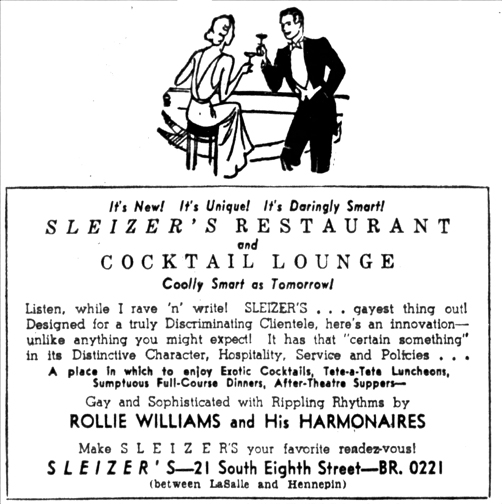
Minneapolis Tribune, July 28, 1940
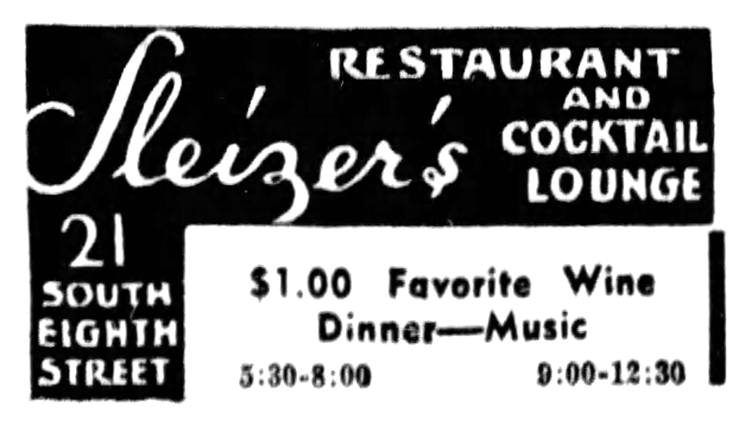
Minneapolis Tribune, February 5, 1941
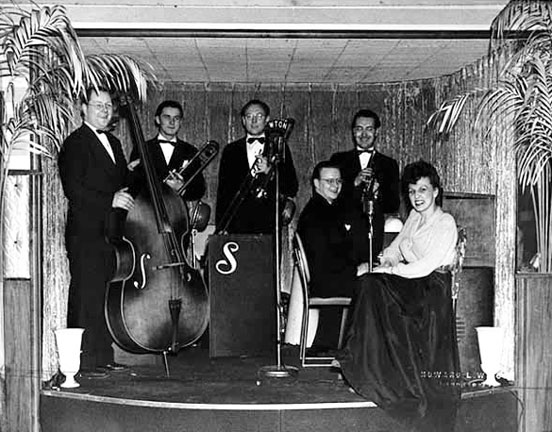
1942 photo courtesy Minnesota Historical Society. Kind of a small stage!
In November 1944 the club featured Harvey Dale and His Men of Music.
The wartime menu below was sent in by Cathy Correa, who found it in her parents’ things. During World War II the family lived in North Dakota, and one of her brothers must have passed through Minneapolis and eaten at Sleizer’s. He kept the menu as a souvenir and it has survived all these years. Thanks, Cathy, for sending the image, and thanks to the McClure brothers, one who lost his life, for serving their country.
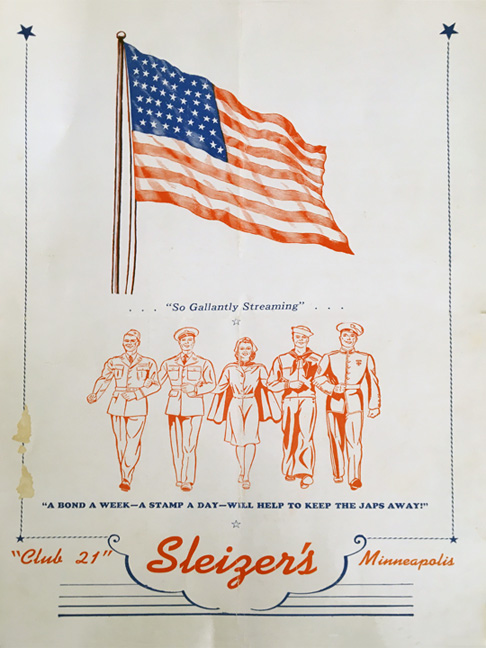
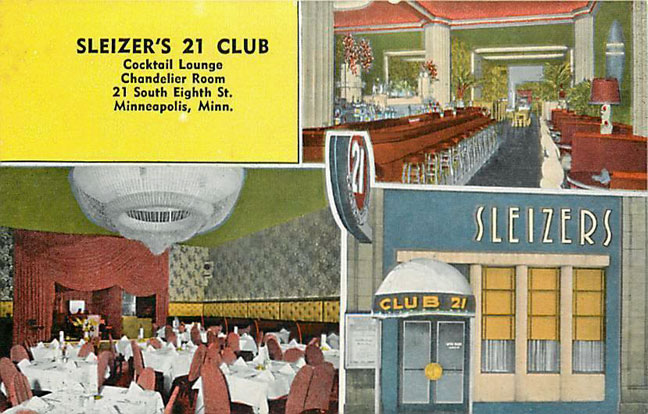
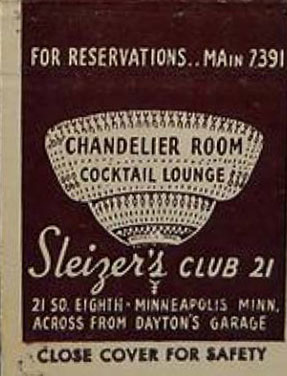
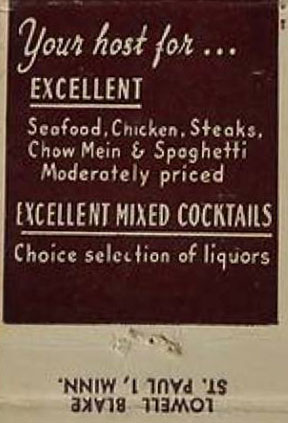
BOWMAN’S CLUB 21
On June 17, 1958, Sleizer sold the restaurant to A.E. “Red” Bowman. Bowman had been the Federal Sugar Administrator during World War II when sugar was rationed. He was also a former general manager of Schmidt Brewing Company, and then his own beer distributing company. Food operations were handled by Harry Doust, the former owner of Harry’s Cafe, and later operated the Criterion in St. Paul. (Minneapolis Star, June 17, 1958)
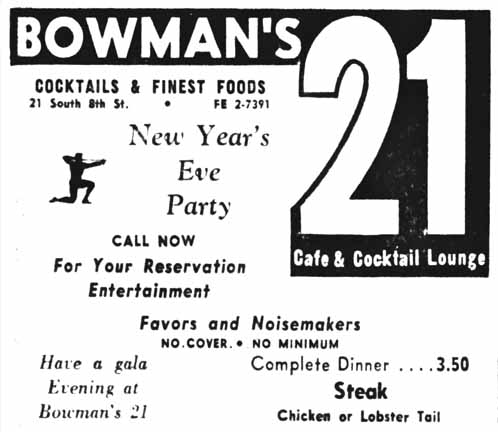
December 19, 1958
Will Jones reported on March 30, 1959, that the club installed a dance floor in the dining room in late March, and would begin its new dance policy on April 1. There was a piano in the front bar.
A comment in a Cedric Adams column in the Minneapolis Star on April 13, 1959, says:
Red Bowman’s 21 Club on 8th St. has had such success with its dancing as a feature that Red is about to add a weekly style show as a diversion.
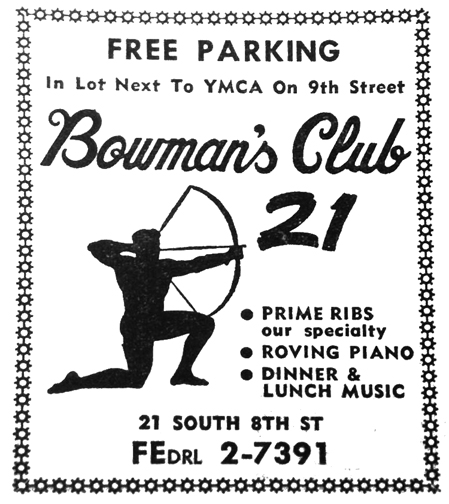
1959 ad courtesy Mark Youngblood
CLUB 21
Bowman sold the club in October 1959 to supervise his personal investments. Bowman’s name was eventually dropped and it was more and more referred to as Club 21.
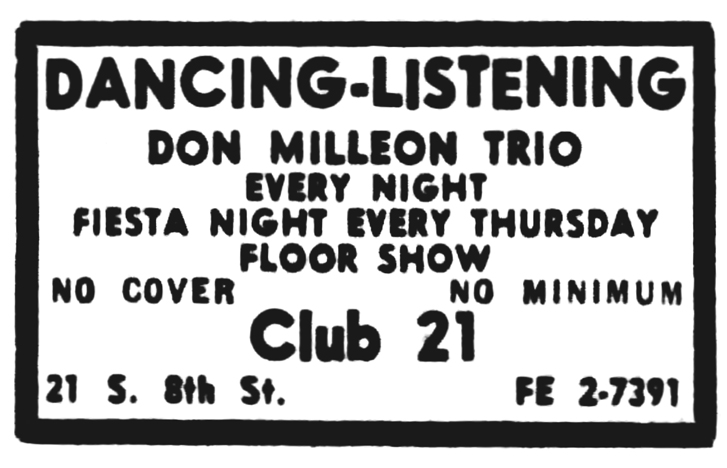
Minneapolis Star, October 11, 1960
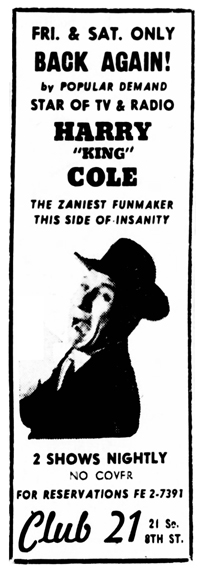
Minneapolis Star, October 21, 1960
DUFF’S
Joseph Duffy, Raymond T. Duffy, and their dad opened Duff’s at this location on July 13, 1962. They had previously owned Duffy’s at 26th and 26th from 1953 to 1960.
MINNEAPOLIS DAILY HERALD
The opening was during the 1962 strike of the Minneapolis Star and Tribune, so it was covered by the Minneapolis Daily Herald. This article, probably written by Irv Letovsky, appeared on July 19, 1962:
JOE, RAY AND DAD: And they each have their own horseshoe bar. That’s the way it is at Duff’s, with the Duffy brothers and their Dad opening up their new club … When they started converting the old Twenty-One club, the Duffys took a look at the old bar room and decided against one long bar that would make the place look like a single alley bowling house. To avoid this, they put in three bars: Joe’s, Rays and Dad’s.
In the back room, Bea Lee reigns with song in a room which can seat 135 persons. And the size of the room might be it’s drawback, since with 50 people in it it looks almost empty.
The Duffys have been working at Metropolitan stadium since the Twins moved to town [1961], but will now devote full-time to Duff’s. Always popular with athletes, it won’t be unusual to find a Viking or a Win in the place on any given night.
THE TRIBUNE
An ad in the Tribune dated May 13, 1963, says “Door to Delightful Dining… in one of the newest and nicest places in town! The Charming Gay Nineties decor… the personal attention by Joe and Ray Duffy, your hosts… the perfect touch with a prepared beverage…the delicious food at down-to-earth prices… the live entertainment and dancing… at this adds up to a delightful dining experience.” Dinner was $1.75!
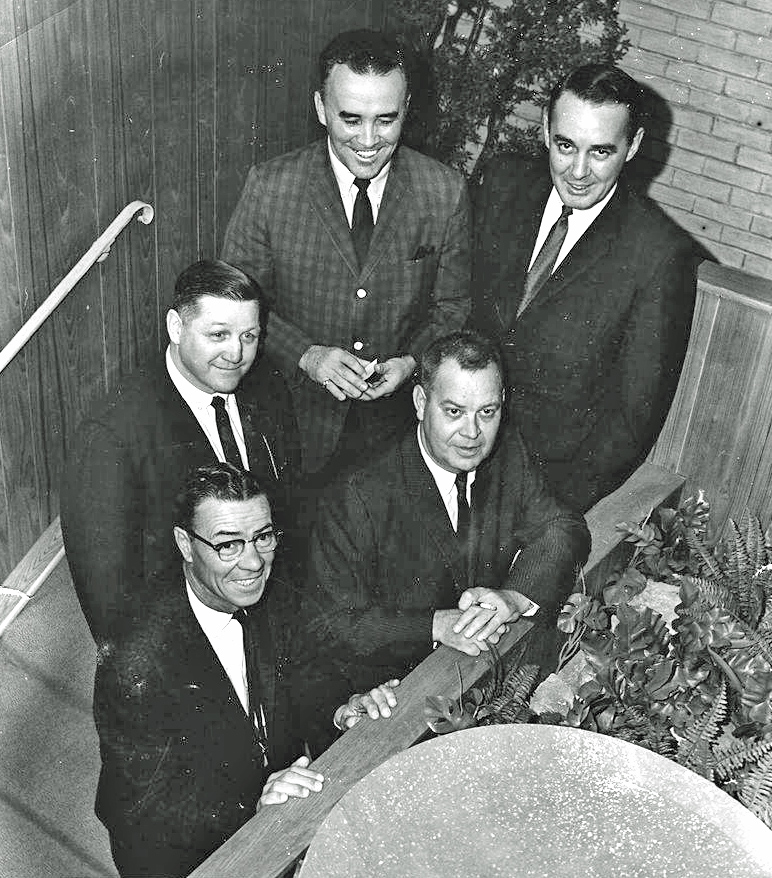
Mike Duffy posted this great photo, taken at the entrance of the Stadium Club, opening day of Met Stadium, 1956. Clockwise from bottom : Angelo Giuliani, (NOT) Joe Robbie, Joe Duffy, Ray Duffy (Mike’s dad), and Cal Griffith.
DON MORRISON ON PIANO BARS
In his August 12, 1962, column in the Minneapolis Star, Don Morrison discusses Joe and Ray Duffy’s courageous decision not to have a noisy piano bar at their new establishment. Don says it best:
The piano bar fad has spread like cholera in the past couple of years, with the result that a person looking for a quiet drink and some conversation just about to settle for a Pepsi in the YMCA lobby.
Morrison asserts (and I paraphrase) that a nice quiet piano or trio is inoffensive. But the cacaphonous din of people yodeling around a piano bar offers competition to conversation so severe that you and your wife might as well just stay home and fight. It’s cheaper.
Morrison quotes Joe Duffy as saying,
I walk around town and see ’em six deep at the piano bars and wonder if I’m crazy. Nevertheless, I hate that noise and hope we never have to bring it in here. I’d rather make 100 bucks less a night than listen to the kind of rumpus that goes on with a piano bar.
Morrison also gives us a glimpse at the layout of the original Duff’s, as it opened:
The front bar is in a rich, masculine semi-1890s style. There actually are three semi-circular bars along one wall with a few booths and some Edwardian settees on the other.
The spacious back room offers the considerable merit of simplicity, with soft green walls adorned only with gaslight globes in wall brackets. It is serene in more than just decibel level. Comfortable banquettes and tables provide uncongested seating. A small dance floor is serviced by Bea and Her Consorts, who play unpretentious and danceable music. It is an extremely pleasant room, at which I took one look and settled down for the evening.
WILL JONES
On October 1, 1962, Will Jones described the new Duff’s in his column in the Minneapolis Tribune:
Duff’s is done up in what you might call Semi-Gay 90s. The front room is just a handsome bar (or rather a series of three bars) that is becoming a sports hangout. The back room is a listening and dancing room on the quiet side, with the Hal Lichterman trio and singer Bea Lee providing jazz that invites, but does not compel, dancing. Often as not it stimulates quiet conversation and handholding by the twosomes that seem to favor the room.
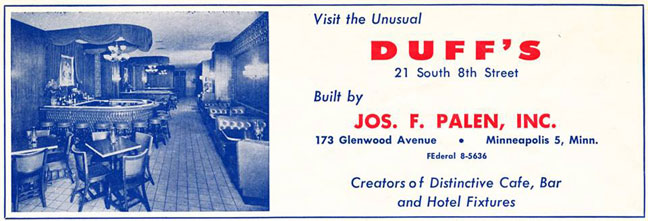
1963 ad courtesy Robb Henry
Duff’s was a hangout for celebrities, especially wrestlers and athletes. And newscaster Dave Moore, they say.
Duff’s held the Duff’s Celebrity Golf Tournament for many years.
In March 1964, Duffy’s at 26th and 26th came back into the family when its liquor license was transferred back to Raymond T. Duffy. His brother, Joe, would continue to run Duff’s downtown on his own.
THE PIANO BAR WINS
In September 1964, Will Jones reported that Duff’s had a new piano bar called Duff’s Upstairs,
a low-ceilinged room where the customers sit on the floor on pillows. The piano is sunk into a kind of pit so that the pianist is on a level with the customers. Joan Tereese Blakkestad is in charge of the piano every night. She’s now billing herself simply as “Sweetie.”
In 1965 they danced in the Blarney Room.
The Titans were their house band in 1967 – 1969. I just bought a copy of “Ode to Billy Martin” by the Titans – on the Duff’s label, produced by Jim Madison. Flip side is “Please Don’t be Angry,” credited to Lorna versus The Titans.
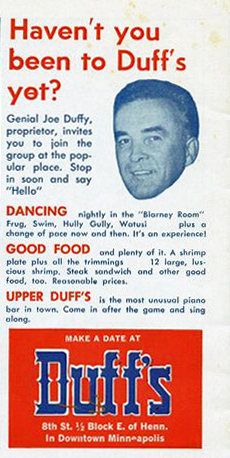
In 1971, Joe Duffy also became a co-owner of Duff’s in the Park, in St. Louis Park. He sold out in January 1976.
Ralph Hitchens was the manager of Duff’s in 1972.
Batch was the house band in 1973 – 1974.
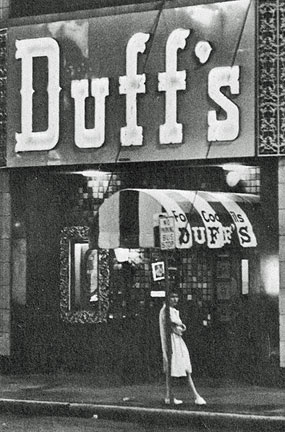
This photo is from a 1969 Connie’s Insider. Caption reads: “Duff’s in Downtown Minneapolis has long been noted for its pop music action and the abundance of pretty chicks.” Photo courtesy Paul Strickland.
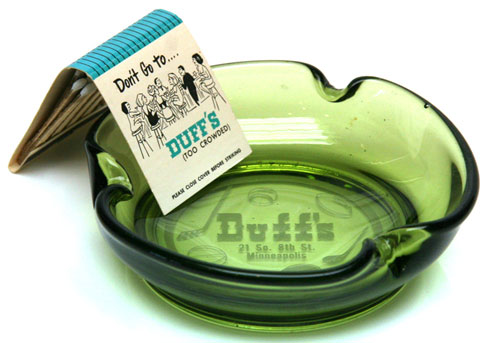
I posted the photo below not knowing anything about it, and Paul Hilcoff provided the answer! It was taken by Donald Emmerich as part of a study commissioned by the EPA to examine the “adverse effects of modern life on the environment.” And then Robb Henry told me it was his band, Walter Mitty! Pictured are lead singer Mark Anderson and singer/guitarist Wayne Fish. Out of the shot are Robb and three other band members.
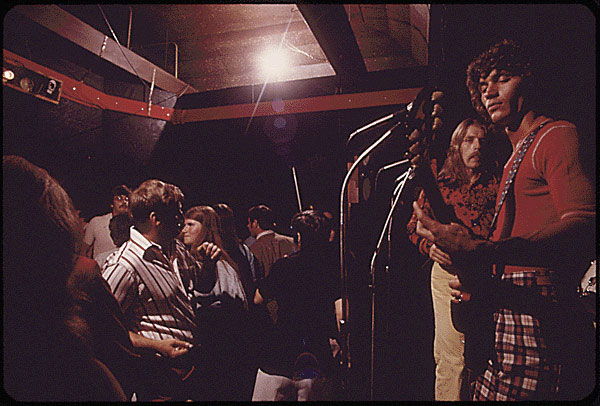
Walter Mitty Band at Duff’s, 1973
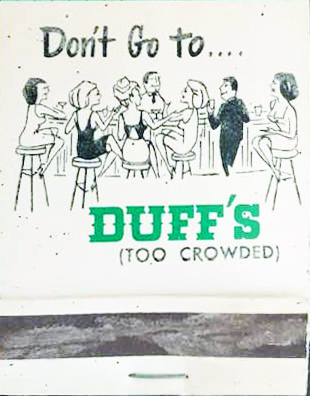
Image courtesy Danny Mulvehill
Owner Joe Duffy retired in 1977 to become the general manager of the Olympic Hills Golf Club.
The club was bought by Robert McNamara in October 1977. McNamara was a former all-American halfback at the U of M in 1954, played football with the Winnipeg for four years, and with the Denver Broncos for two years until four knee operations ended his career.
On November 9, 1978, there was a three-alarm fire at the Creative Furniture Store, next door to Duff’s. Duff’s suffered smoke damage.
The Jesus People Church bought the State Theater, the Duff’s building, and adjacent buildings for about $2.25 million in November 1978.
On December 24, 1978, a five-alarm fire burned the Duff’s building to the ground, taking the restaurant and five other businesses with it. The five degree temperature made fighting the fire difficult when hoses froze to the ground. There were no injuries, but the roof caved in and the Red Cross found alternate housing for apartment dwellers on the second floor. Fire investigators concluded that the fire was the result of arson, as it showed signs of being started on both sides of a firewall. Motives ranged from opposition to the Jesus People Church deal to an attack on the Planned Parenthood office that was in the building.
The building was demolished, in whole or in part, in the spring and summer of 1979. 230 autographed photos of famous customers were destroyed. One of Duff’s most interesting regulars was Edmund Gould, a stockbroker who spent $8,000 to have his own booth and phone installed. (Minneapolis Star, November 23, 1979)
McNamara had had a lease from the Jesus People Church until 1982, but he wasn’t sure the church would honor it. He also didn’t think his insurance would be enough to rebuild, so he decided to relocate instead.
829 HENNEPIN AVE.
McNamara moved Duff’s to 829 Hennepin Ave., the former location of the Cascade 9. It opened there on March 1, 1979.
There were two Smuggler’s Inns in the Twin Cities. They were part of a chain that originated in Beverly Hills, California.
ST. PAUL
A Smuggler’s Inn restaurant opened in the new Kellogg Square complex in St. Paul in about November 1972. The address was 111 E. Kellogg Blvd.
Will Jones didn’t have much to say about the entry to the establishment, but once he got inside he was pleasantly surprised:
Inside, it’s amazing how much Instant Atmosphere can be ladled inside those concrete slabs. The first grabber is a vast square of a fireplace burning real wood logs at least 5 feet long and providing warmth and wood-coal smells to both the dining and the drinking area, between which it is nestled.
The dining area is dimly lighted, sporting a candlelight effect without the nuisance of candles on the table, with heavy, high-backed chairs of Spanish influence and a table setting dominated by a heavy pewter plate to set the mood. (Minneapolis Tribune, November 20, 1972)
An article dated December 3, 1973, noted that:
In a corner room, rock music groups from California perform Monday through Saturday nights, and you don’t have to be under 30 to dance. (Minneapolis Tribune)
The St. Paul location became a popular after-work drinking spot, and in the late ’70s it was a disco that was not as crowded as the more chi-chi Oz.
The last wantads for help found in a Strib search were in 1986.
NORTHTOWN
The second location was in the Northtown Shopping Center in Blaine, where it was called the Smuggler’s Inn Dinner House in an early article. It opened in about September 1983.
This location, based on wantads in the paper, appeared to have lasted until 1981.
Snail Lake Tavern was located at 4255 Snail Lake Blvd. in Shoreview, “right on Snail Lake.”
According to Images of America Shoreview, Minnesota by Verna Rusler, the Snail Lake Tavern was founded in the early 1900s on the route of the Mounds View Pony Express. A tiny grocery store adjacent to the club served “men of means” who came to nearby resorts to hunt and fish.
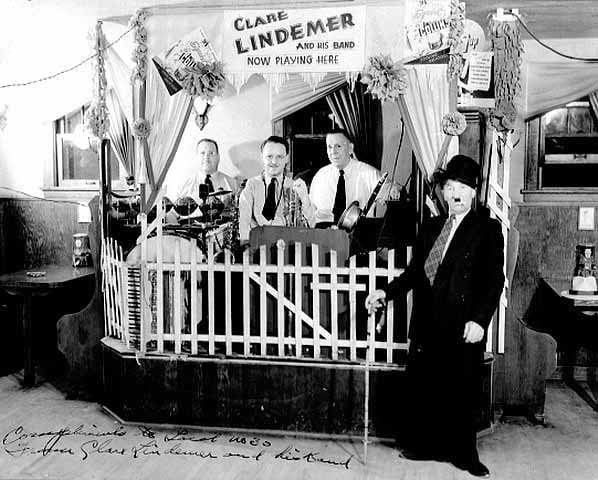
Clare Lindemer and His Band at Snail Lake Tavern, @ 1930. Photo courtesy Minnesota Historical Society via lyfmap.com
In the 1930s, the club was frequented by Chicago area gangsters such as Al Capone, Ma Barker, John Dillinger, and Baby Face Nelson, according to Rusler, although Capone was not prone to linger in Minnesota.
When Prohibition ended, the tavern served beer, soda for customers to add their own liquor to, and food. They also had punch boards and a pinball machine.
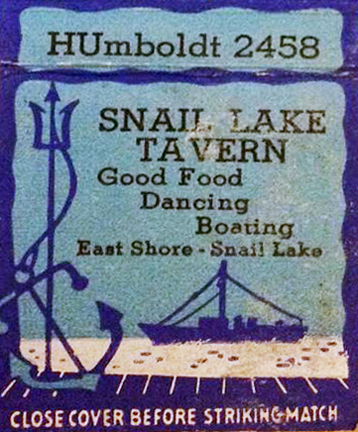
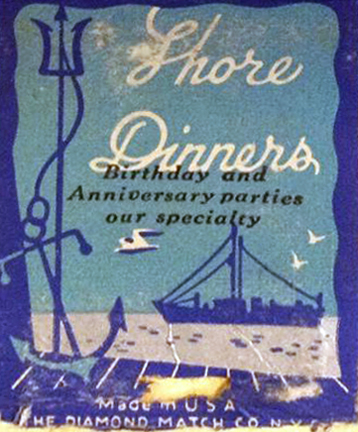
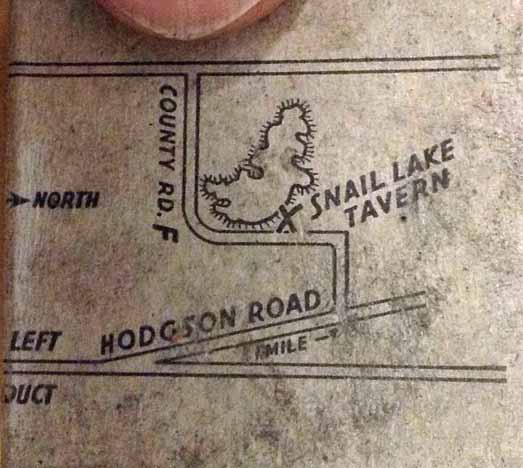
In March 1944 there were notices in the Minneapolis papers that it was closed for repairs.
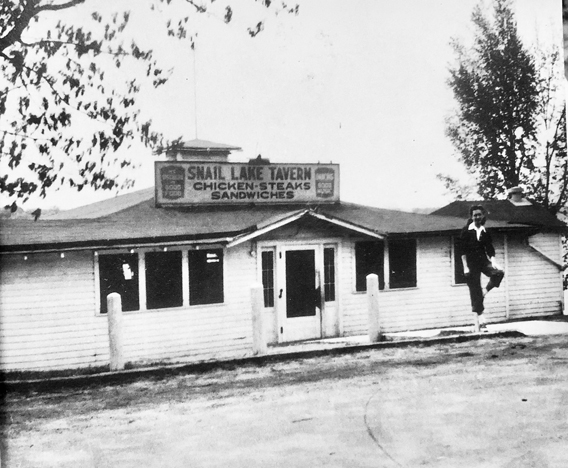
1946 Photo courtesy Minnesota Historical Society, via lyfmap.com
Frances Springer, a teacher, opened the “bottle club” into the 1950s.
In April 1953 it was run by Mr. and Mrs. H. J. Nelson. Mrs. Nelson had written to the paper protesting that not all taverns were places of ill-repute.
SNAIL LAKE SUPPER CLUB
The name of the place was apparently changed to the Snail Lake Supper Club by 1963, and dancing to an orchestra was offered, although the orchestra may have consisted of a three-piece band on some nights.
From 1966 to 1988, the tavern was owned by Al and Gloria Buetow. The club served the community as an old time dance hall and the location of wedding and other receptions. (Rusler) Picnicing, swimming, and fishing were also available.
Below is an ad from a 1969 desk blotter put together and distributed by Pat Richie, late owner of Richie’s Razor Repair. It shows that Pat Lang and Joe Rosenthal were the owners.

Image courtesy Landon Vath
The club was demolished in 1988.
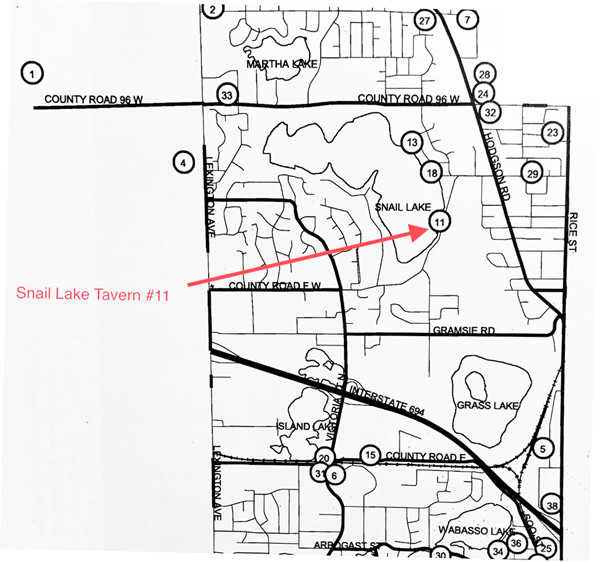
Snyder’s Cafe was located at 38 South 6th Street in Downtown Minneapolis, across from Juster’s men’s store.
The first floor was a jazz club from 1934 to the 1940s and possibly longer.
The second floor hosted some questionable gambling.
In the 1930s it was a place to go to buy ticket for local events.
A report of a fire on February 22, 1941, confirms that an orchestra was employed.
Charles Rothenberg was listed as the proprietor in August 1947.
An article in a newspaper called the Times – the Picture Paper, the ownership of Snyder’s and the adjoining liquor store is called into question, with several potential owners. These include Dave Snyder, Eugene L. Heck, Darlene Snyder, and possibly Sam Snyder (the language is ambiguous). (October 17, 1947)
Percy Hughes led the house band from 1948 to 1949, followed by Vic Turrito.
In October 1949, the manager was Palmer Norum.
Bruce Dybvig had a short stay, followed by Eddie Bach in 1950.
Dave Snyder, listed in his obituary as a co-owner, died in June 1951 after retiring in 1946. His brother Max, who owned the chain of Snyder Drug Stores, had recently died as well.
On Sunday, February 10, 1952, a fire started in the kitchen of the empty Cafe, and spread to the rest of the building. High winds kept the flames going and the fire damaged adjoining buildings as well. Samuel S. Snyder was identified as the owner, and Glenn Anderson, the operator. The top two floors of the three-story building were only used for storage and for dressing rooms for entertainers who performed there. A steam tunnel under the street carried smoke to the lobby and basement to the Dyckman Hotel.
In April 1952, the second and third floors were removed. That June, two stories were built in the front, and one in the rear.
In 1967, the entire building was demolished.
It was replaced by a 29-story office tower called Fifty Sixth South Sixth, which opened in July 2001.
The So Chu Inn Chinese restaurant was located at 18-20 South Fifth Street in Minneapolis.. It was in the space formerly occupied by the McCormick Restaurant.
The Proprietor was J.F. Wong. There was a scare when the newspapers reported that a J.F. Wong had been murdered in the course of a “Tong War,” in February 1925. This was a vicious rivalry between three different Chinese gangs, or businessmen”s associations, as they were sometimes called. It turned out that the J.F. Wong who was killed was the brother of the So Chu’s Wong.
The So Chu had a dance floor, with an orchestra with which to do the Fox Trot. However, some singer in the place had sung the song “Margie,” and Wong was caught without the rights to it, so the song’s composers sued him. He was fined $10 and court costs and warned not to do it again.
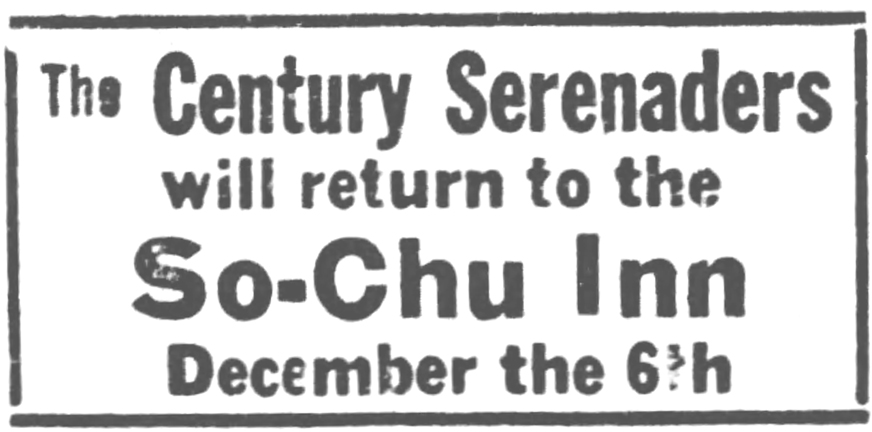
1920
Please see the Cotton Club at 718 Sixth Ave. No.
In 2015 I stumbled upon the Keeper of the Flame of Someplace Else, Annette Flaherty, who, with her husband John, built and ran this fabled club in downtown Robbinsdale. Here’s their story, with many thanks!
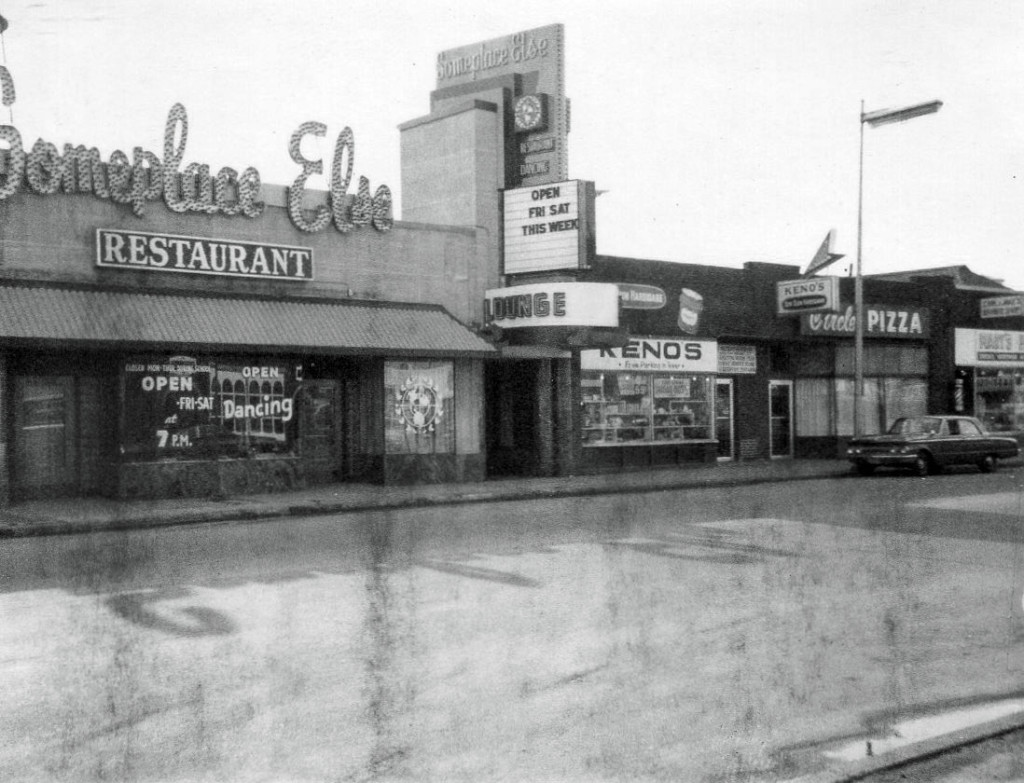
THE HOUSE OF WOO / ROBIN LANES – 4123 West Broadway
John C. Flaherty was a contractor, and took pleasure in making something out of nothing. While an abandoned Chinese restaurant full of grease (yuck!) and the old 6-lane Robin Lanes bowling alley may have looked like a mess to most, John had the vision to picture a swanky restaurant and nightclub – perhaps the one and only in the history of Robbinsdale. Being a Robbinsdale resident and finding this space available, he set his sights on the property, which was owned by Sidney Volk, who also owned several theaters, including Robbinsdale’s Terrace. When asked why he focused on such an improbable endeavor, John told the Music Scene, “Maybe I’m trying to modernize an old town.”
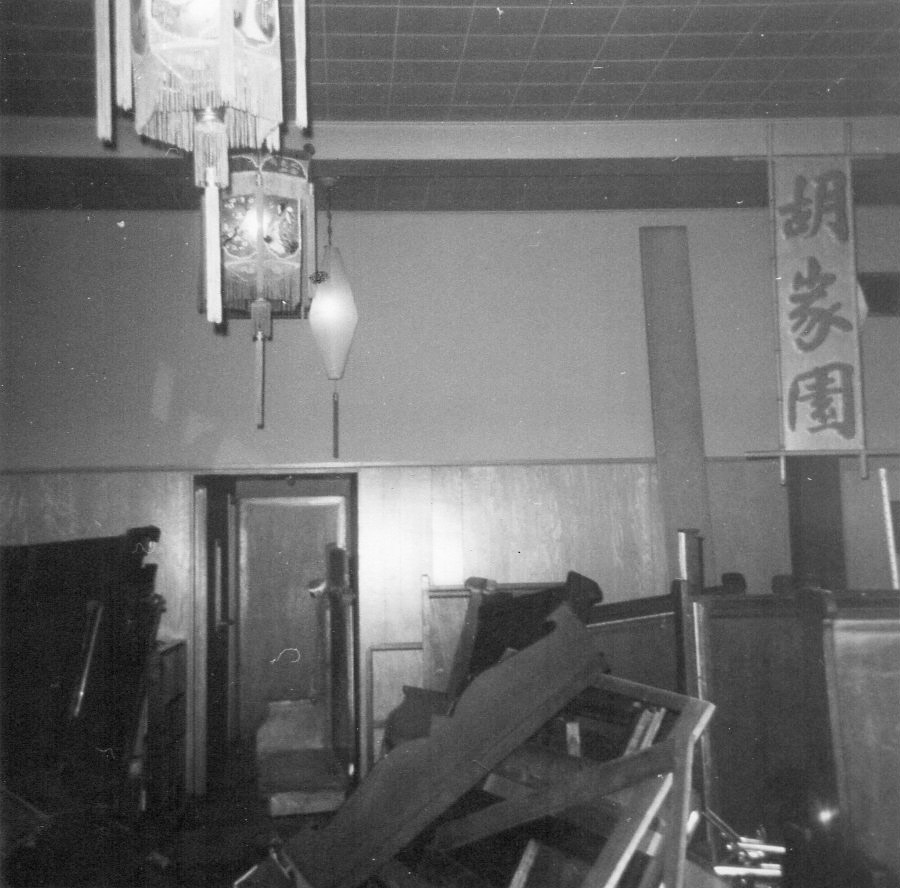
The House of Woo
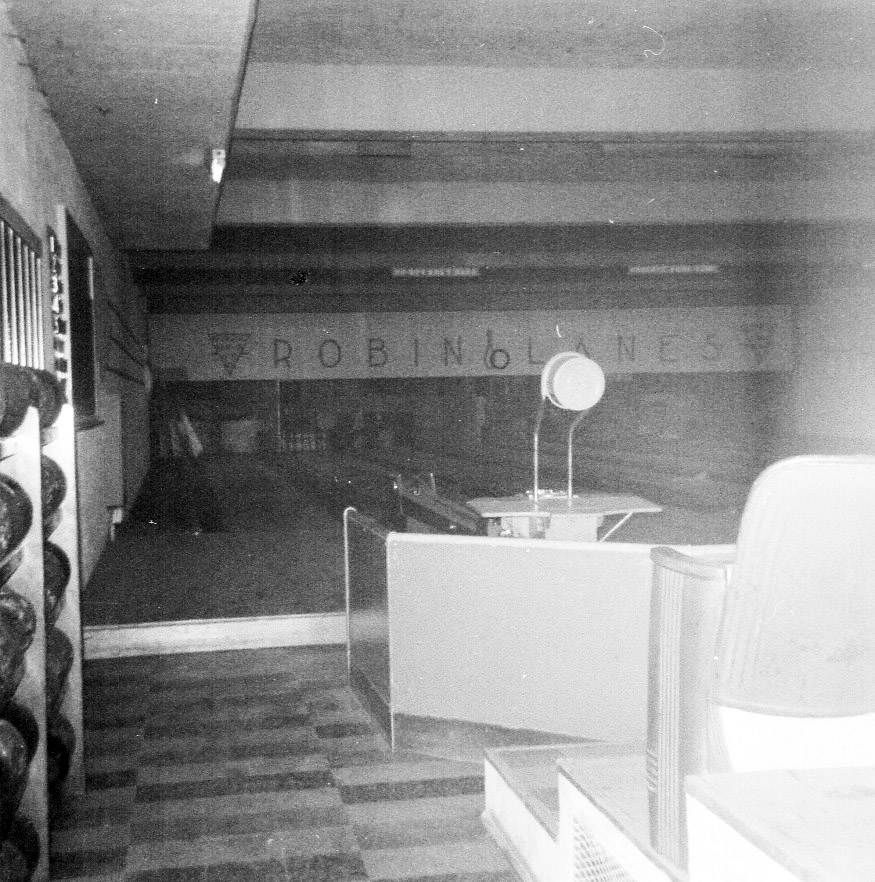
Robin Lanes
BIG PLANS
John’s initial idea for Someplace Else (a name he got from a bar in Wisconsin) was an adult nightclub, with a white tablecloth restaurant in the former House of Woo and a dance floor and stage in the former bowling alley. He approached members of the City Council about getting a set-up license, was given good vibes, and went ahead with his plans. Since Robbinsdale had a municipal liquor store and lounge, all he could hope for was a place where the club provided set-ups and patrons brought their own liquor.
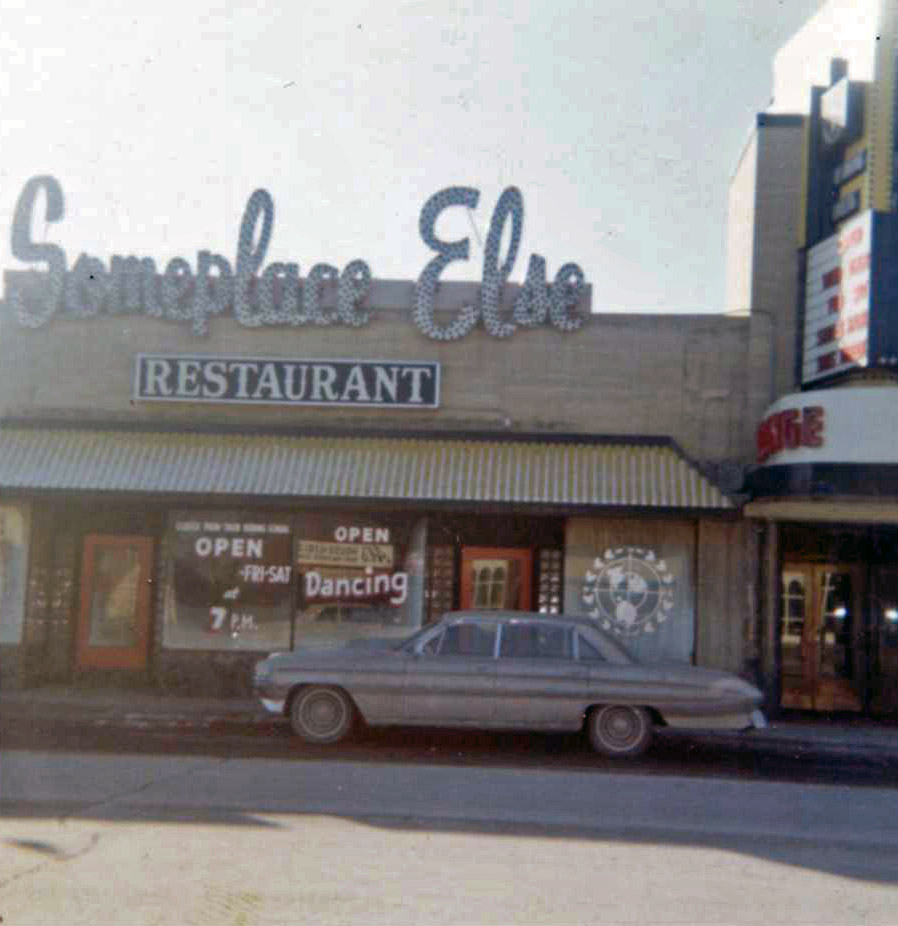
Based on that understanding, in November 1966 the Flahertys, along with partner Ralph L. Reiter, proceeded to spend $60,000 in remodeling and furnishings to make it the “swankiest restaurant and night club that has ever been opened in Robbinsdale.”
THAT SIGN!
The club’s spectacular sign was the largest on West Broadway; provided by an investor who had a sign company, it had 777 lightbulbs. When the club went under the sign was just laid down on the roof; Annette says it might just still be up there!
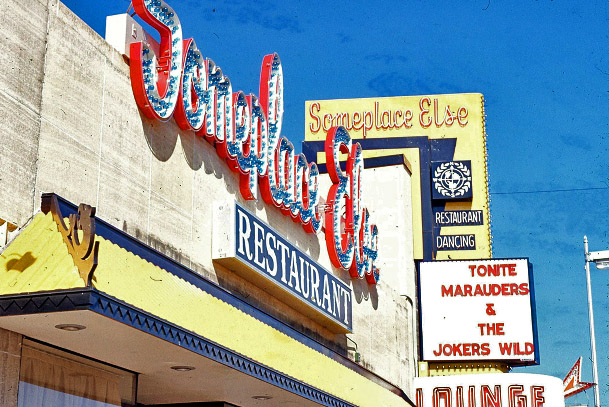
TRICK ENTRY
Don Morrison of the Minneapolis Star described the place as “a former bowling alley that has been converted into a cheerfully nutty layout. You enter from the street into a dead-end foyer. Then, after a financial transaction at the admissions wicket, a wall bookcase slides upward to reveal the entrance to the real ‘else place.”
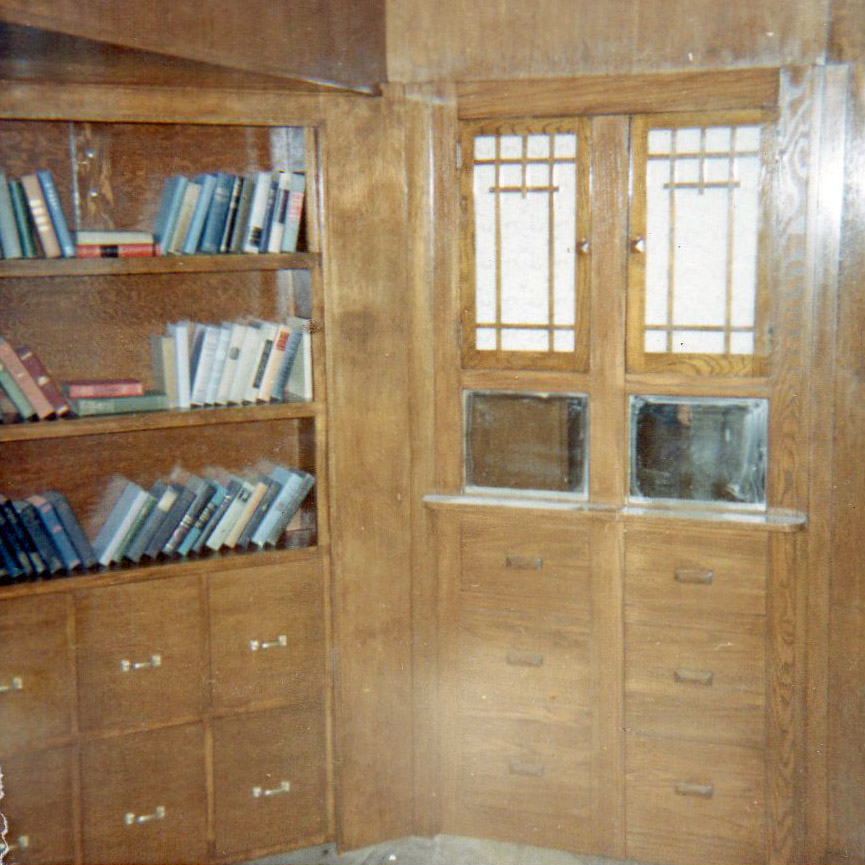
Wait? Where do I go now?
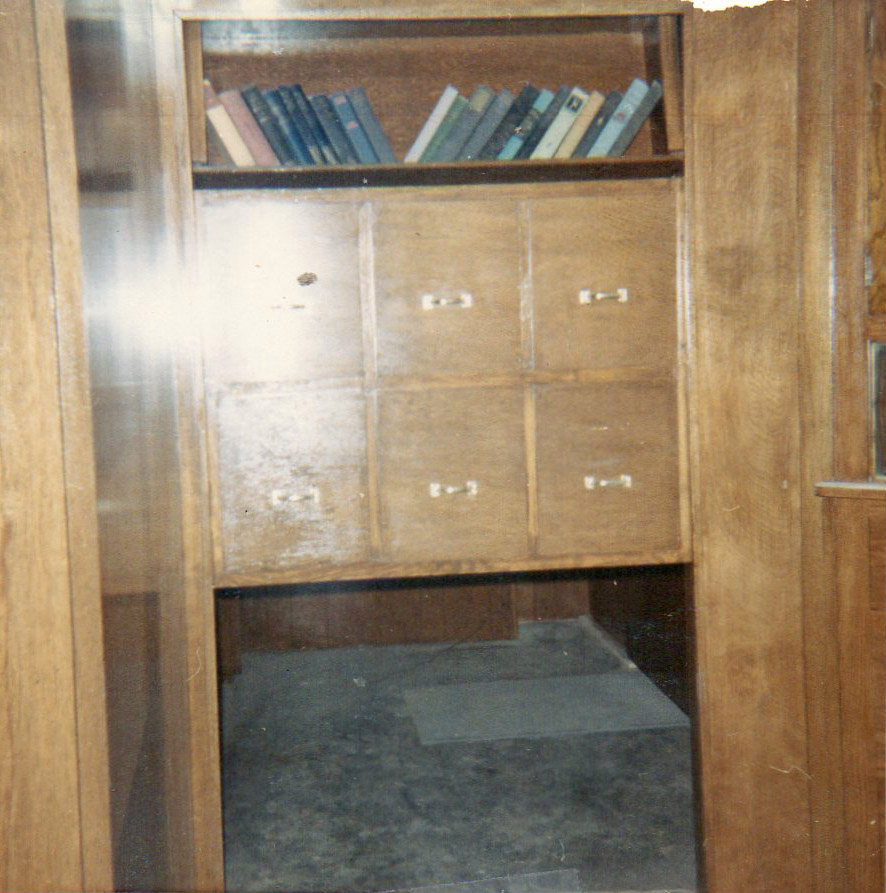
Okay, I see! Very tricky! The door was activated by an operator at an old switchboard.
TRULY SOMEPLACE ELSE
The idea behind Someplace Else was that you could instantly move around the world. The bar had themed rooms: Paris, Ireland, and South Seas. Here’s the South Seas room in the midst of being decorated; it would eventually include aquariums.
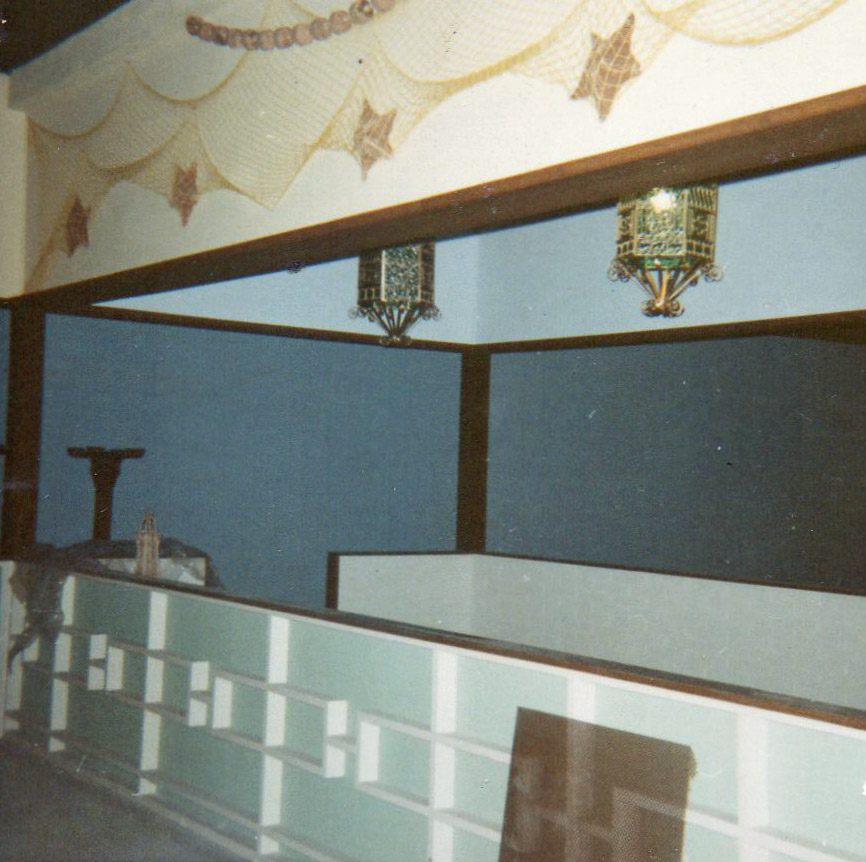
ADULTS ONLY
At first the club was only open to those 21 and over. After all the promises, Flaherty had only been able to get a license to serve 3.2 beer, and it took a lot of haggling to get that. Finally the club opened on March 22, 1967. Entertainment during this adults-only period included:
- The MOB, a 7-piece group from Chicago that dressed like gangsters, March 22 – 28, 1967. The group was assembled and led by Jimmy Ford, musical director of Dick Clark road shows.
- The Hollywood Argyles, March 29 – April 11, 1967.
- The Everly Brothers, April 3 – 9, 1967. (two 3 hour shows nightly). Annette says that Phil and Don couldn’t have been nicer, and hung out with the customers between shows.
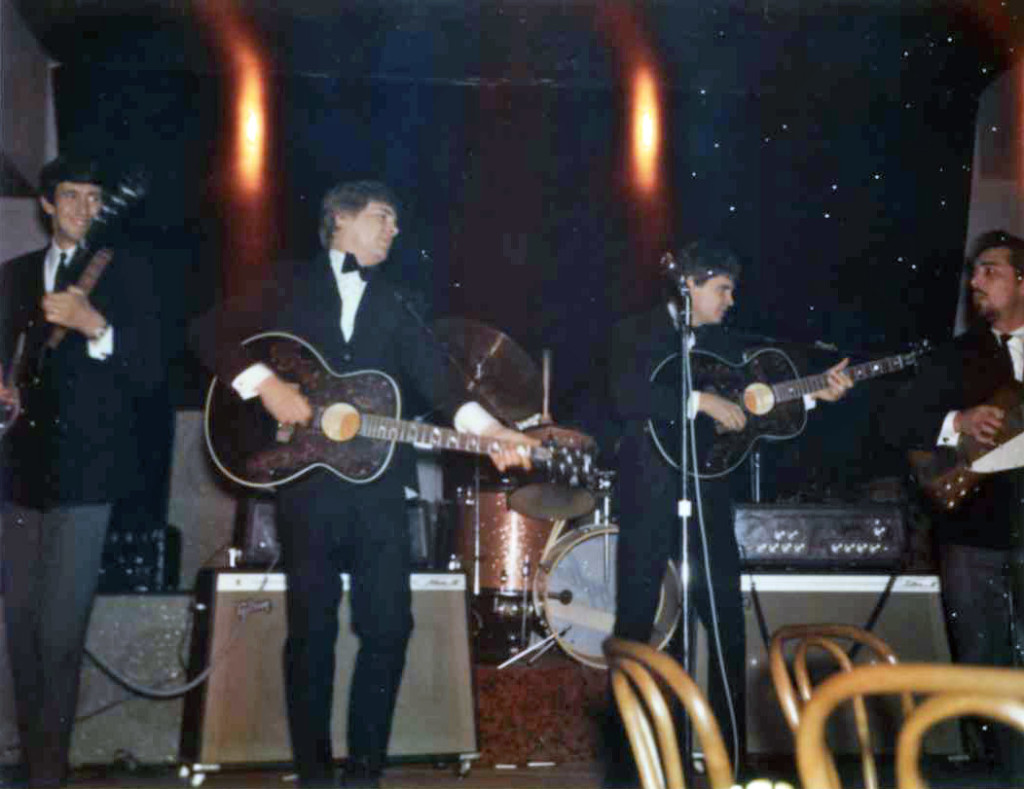
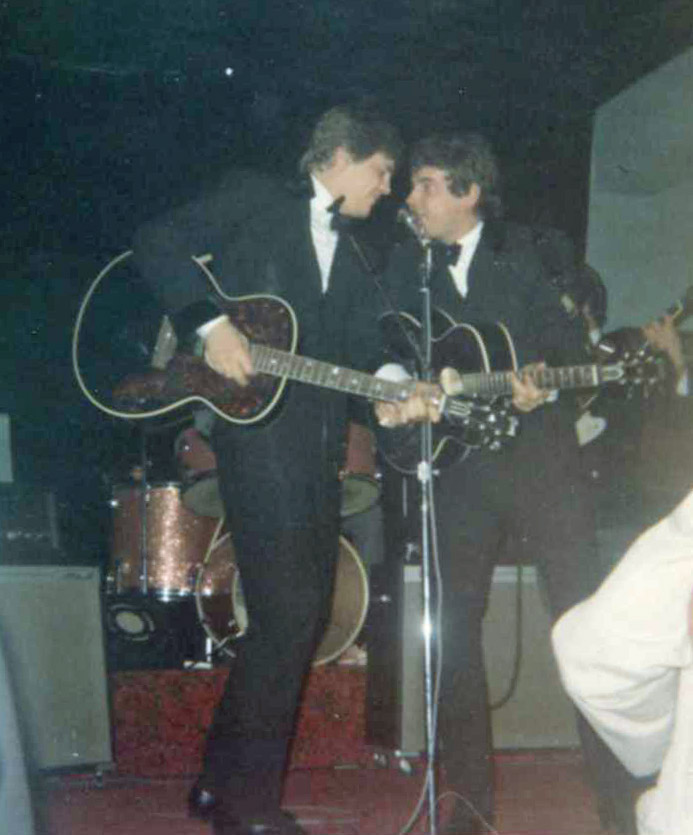
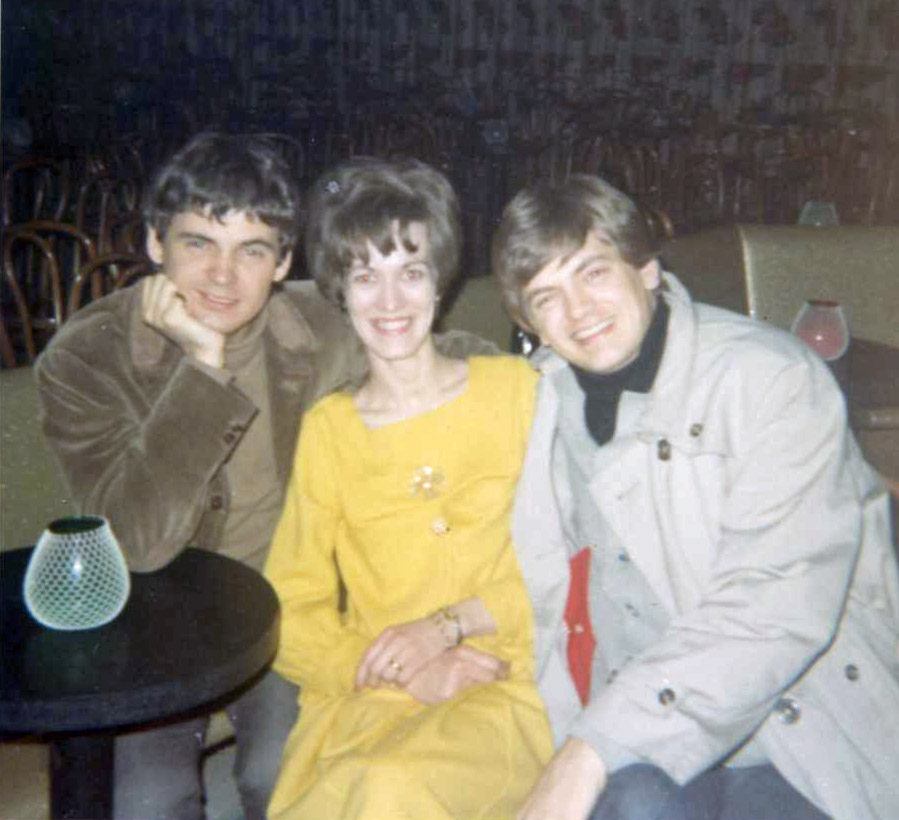
Don and Phil hanging out with our Annette!
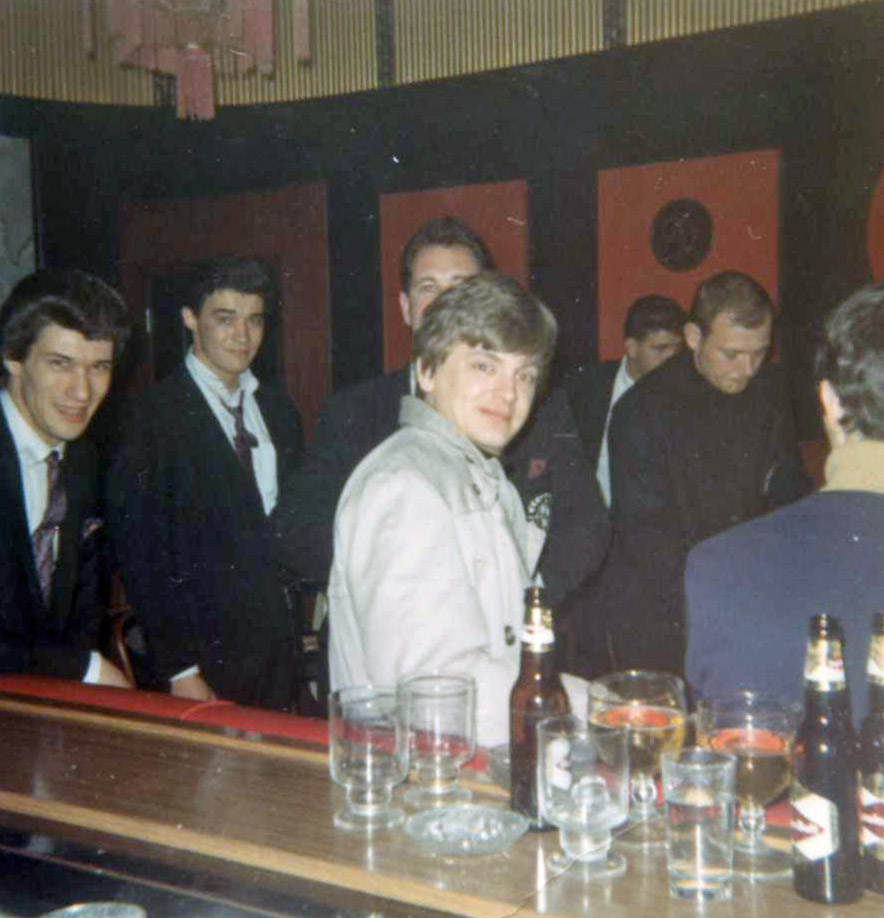
The Everly Brothers and all the Grain Belt you can belt!
- Vic and the Versatiles, “big sound from Chicago,” April 10 – 23, 1967.
- Bobby Goldsboro, April 17-23, 1967.
- The Big Beats, a 3 women, 2 man group from Las Vegas, April 24 – May 5, 1967.
- Ramsey Lewis, featuring Cleveland Eaton and Maurice White, May 9 – 14, 1967. After two nights Lewis pulled a muscle in his wrist (“an old injury”) and had to cancel. John: “It may have been legitimate, but some people thought it did look funny.” (Music Scene)
- The Fendermen, May 8 – 14, 1967.
- Los Blues, a group from Texas via the Sahara in Las Vegas, June 5 – 11, 1967.
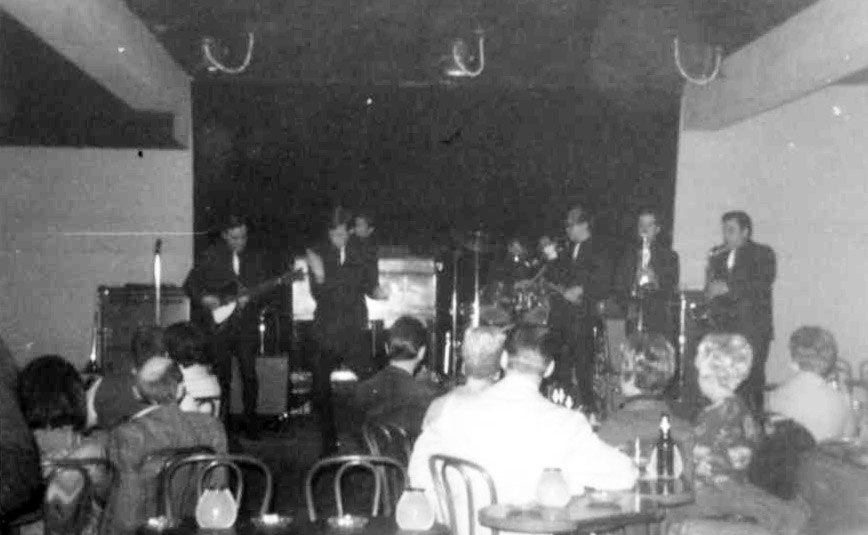
The Mob
- Sarah Vaughn with the Bob James Trio, June 12 – 14, 1967. Miss Vaughn conditioned her appearance on having a private dressing room and John built her one. She came by herself, just in time for her first performance. Will Jones quoted her in his June 15 column:
- ‘I’ve never worked in a place like this before,’ she said. She is part of a continuing experiment to see if substantial jazz and pop performers can’t be booked alongside the rock groups that are the bread-and-butter attractions. ‘I have the feeling that there are kids who come just for the rock, and there are people who come just to hear me,’ she said. When it’s time for me, the kids get up and leave. Some of them look like about 10 years old.’
- The MOB was brought back June 15 – July 2, 1967.
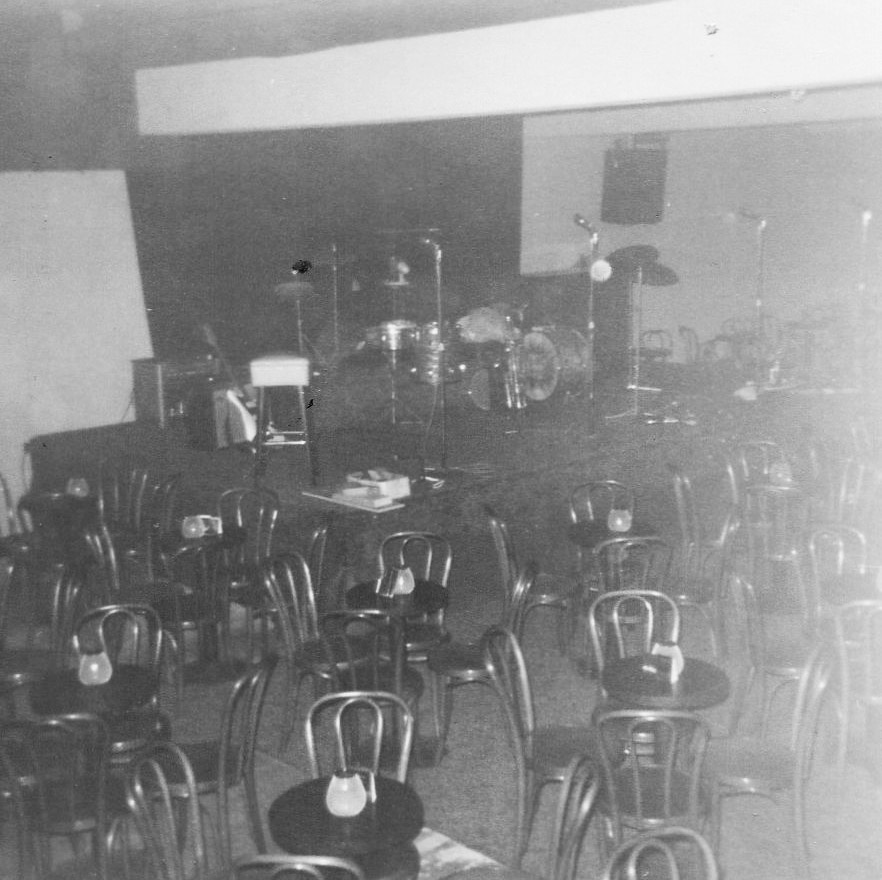
Snapshot of the adult club
GOING BROKE
The restaurant had opened in May 1967, decorated in a Roaring ’20s decor, but things weren’t going well. Robbinsdale was a tough sell, with a reputation as a sleepy suburb. On June 22, , 1967, Jim Klobuchar reported: “Night Club Owner is Bitter – Robbinsdale Takes its Lumps.” He quoted John as saying that club may have to shut down “because the town council is acting like a bunch of farmers. The town is a backward place with a dead bottom and a main street you can shoot a cannon down at 8 pm without hitting a soul.”
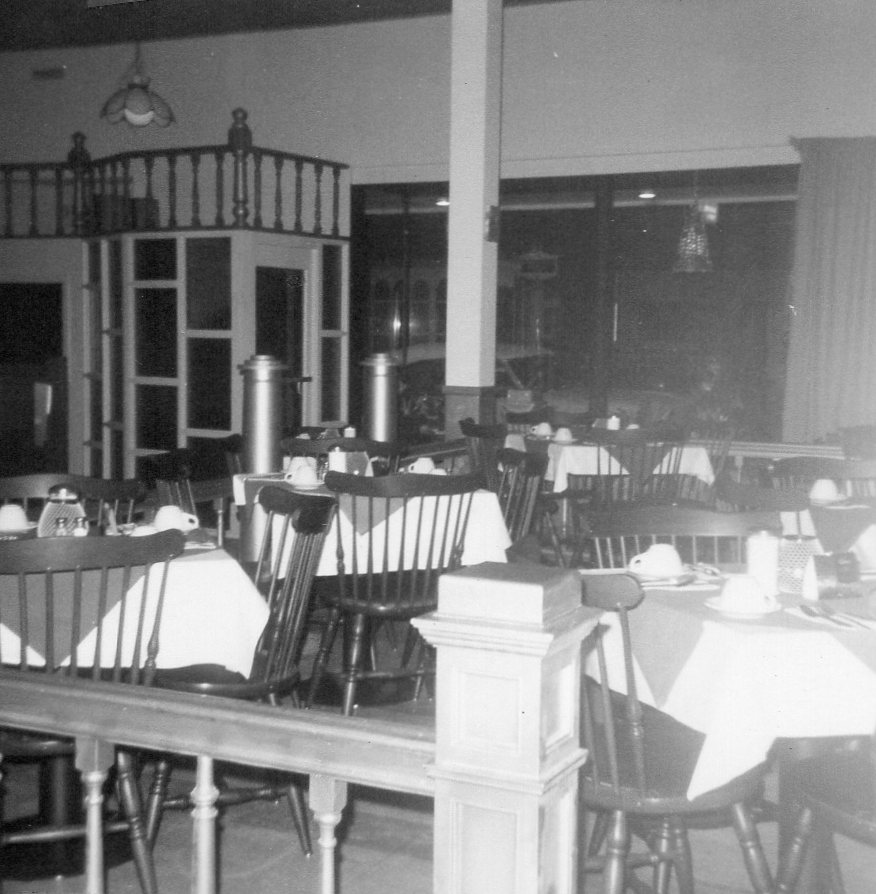
Someplace Else’s short-lived restaurant
LIQUOR WARS
The biggest problem was liquor. With only a permit to serve 3.2 beer, the appeal in an era of hard liquor was limited. John bemoaned that Sarah Vaughn’s shows had an impressive turnout “except that we had to charge $3.50 per head cover charge because all we had was the 3.2 beer. And we had to charge 75 cents for that. There is just so much 3.2 beer a person can drink before developing symptoms of bloat.”
Although the Mayor said that the businessmen on Broadway felt a club with a bottle license would boost the economy, others worried that granting one application might start a flood and cause too much traffic. One alderman thought West Broadway would become another Washington Ave. skid row!
THE MUNI
One of the biggest opponents of changing the City ordinance to allow “spiking” was Alderman John Joe Johnson, “who does most of his drinking in Crystal,” John averred. Klobuchar said that Johnson did not deny it. One of the reasons for that was that the municipal lounge was, in the words of the Mayor himself, “deplorable. You not only would not want to take your wife in there, you would not want to take your girl friend in there and there are times when you are having a snort when you wonder why you took yourself in there.” Klobuchar noted that the lounge “achieves a distinction of being loud and gloomy at the same time. It got so bad that the bartenders, when asked for a shot, were not sure whether the customer was talking about Old Taylor or tetanus.” Naturally the Twin Cities’ most popular journalist was hung in effigy, but his comments also prompted city leaders to spruce the place up: “They have built a new circular bar, decorated the front with stonework, hung some psychedelic lamp fixtures from the ceiling and put in a little elevated lounging stage that is flanked by a wrought-iron railing and firmly establishes the parlor as the Little Paris of West Broadway. The freshly-paneled walls are not only attractive but have the added virtue of convenience for some of the better lubricated customers, who can now carom off the walls in comfort and without physical danger.”
John Zieba tells us:
On sale was the light stone colored storefront and there was an off sale store to its left. The city moved the off-sale across 52 to Robin Center and expanded the bar into the extra space. My father, uncle and neighbor all tended bar there but retired before I was legal drinking age. Nonetheless, I remember it being a dump long before it was modernized, and it did move up to a nice dump by the time I got back from overseas.
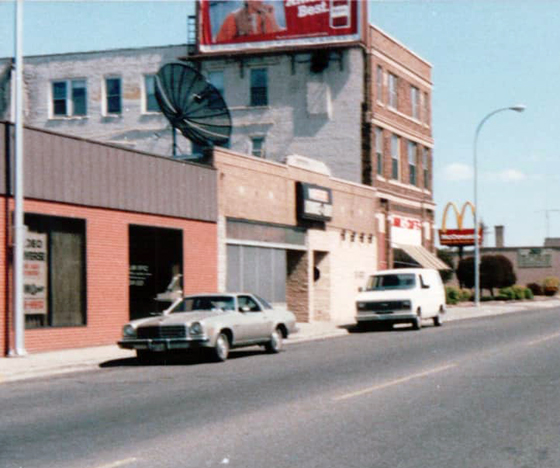
Photo courtesy John Zieba
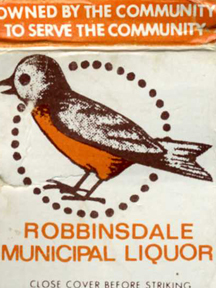
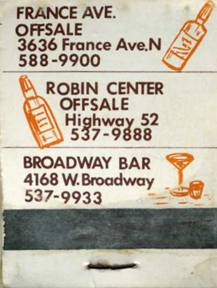
TEENS GO SOMEPLACE ELSE
Finally the Flahertys admitted defeat. They abandoned the restaurant and made their sophisticated adult night club into a teen club, open to kids ages 16 to 20 only. It was a hit! Teens poured into town, and all of a sudden Robbinsdale was happening! Annette says that she’s sure kids were filching money from their parents – they’d pay with silver certificates or rare coins from coin collections.
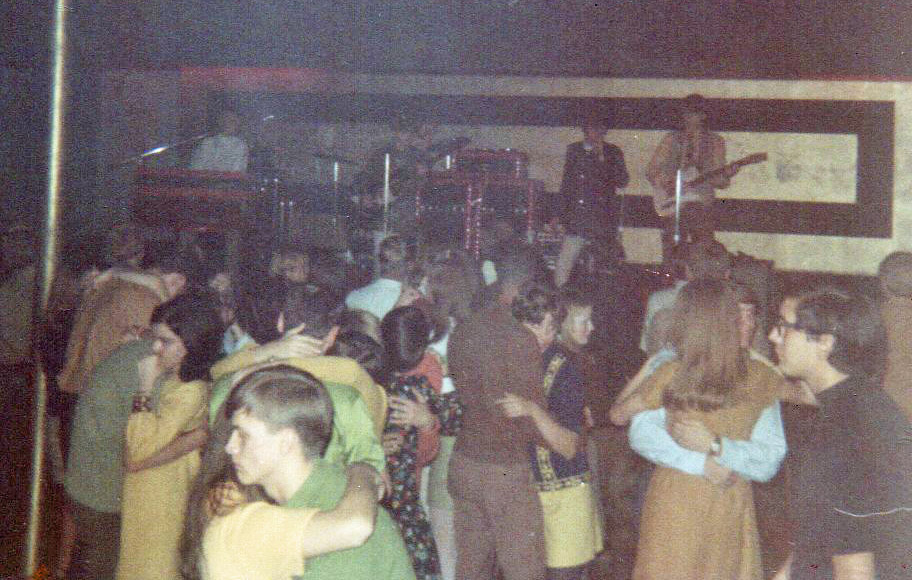
Well, this scared the townspeople to death. An indication of the antipathy toward the club is a letter dated Feb 9, 1968, from the City Manager to John outlining security requirements. “Finally, we must remind you that our men are over there to fill a legal need require of you and not necessarily of their own desire. We must both recognize that we have a man power problem that is going to become acute if: (1) any of our men do choose not to work for you or (2) if the hall is opened additional nights other than Fridays or Saturdays.” Ouch!
John was all over security, though. One innovation was the hiring of kids from each high school, clad in sports coats, as bouncers to keep their friends in line. All jackets, coats, and purses had to be checked, and they even installed one way mirrors in the men’s room (unbeknownst to the boys) so they could keep an eye out for contraband. (Just try that today!) There was a strict dress code, and kids knew that they were expected to behave themselves.
There was even some profiling going on: John said “We’ve turned a lot away for dress purposes – like cycle gangs – and we’ve spotted guys that are looking for fights and made them leave.” Robbinsdale raised his license from $200 to $1000 because “if the club decided to call the Robbinsdale Police Department this would reimburse them.” He already has two Hennepin County deputies. “We’ve tried to keep our prices at $1.50 when other places are charging $1.75, but we can’t now.”
A ROCKIN’ PLACE
But despite all the security, the teens managed to have fun. And although John preferred to bring in out of town acts in order to offer “something else,” the biggest draw were the local bands. “We brought in a group from Las Vegas last week that plays rhythm and blues, rock and roll and are a lot more polished than any local groups. I’m worried though as to whether the kids are too stuck on local bands. If they do support it, they’ll find themselves with a lot of first class entertainment.” Local bands included MET Souls, the Inmates, TC Atlantic, Happy Daze, 25th Century, and the Grasshoppers. Here’s the only other photo of kids enjoying the band.
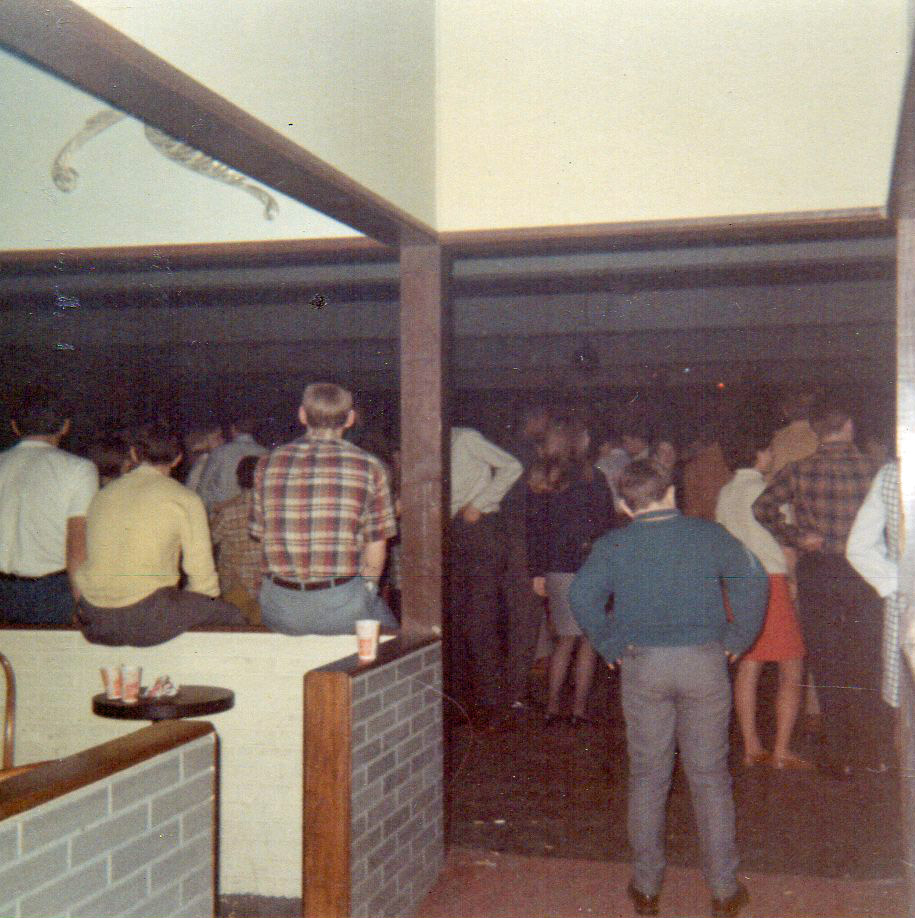
SOUTH 40 AT SOMEPLACE ELSE
On March 20, 1968, the South 40 recorded a live album at Someplace Else. The Insider from March 30-April 6, 1968 described the session. [Master percussionist Chico Perez remembers: “The Buttons opened for South 40 recording night. Little did I know they would be Crow and show the world what’s up in Minneapolis. Wow, so I got lucky and joined the Boys and history tells the tale.Great place that I won’t forget.“]
Capacity Crowd Hears South 40 Live Recording Session
Over 1,000 people packed into The Someplace Else club on Wednesday, March 20th, to hear a “live” album recording session by The South 40 from Minneapolis.
By all standards in the business the session was a success. Much detail and planning had to be worked out and performance by all involved had to be flawless to achieve this success. This article will give you an idea of just what was involved in this huge undertaking.
First off, a club had to be chosen once the South 40, Metrobeat Records, and the David Anthony agency decided to record a live LP.
Someplace Else was picked because the club has good sound and its owner, John Flaherty, was in complete cooperation with the venture. Also the club provided easy access for the recording studio and its equipment.
Also, the club was also using the occasion to celebrate its first anniversary: Someplace Else will have been in business to the teen market one year this July.
Universal Audio was picked as the recording studio to handle the job because the band and other interested parties were pleased with former results at the studio.
Advertising on KUXL, WDGY, and KDWB Radio was purchased to announce the event, and posters were put up in the club weeks before the recording date. Direct mail was sent to all members of the club announcing the event, and discount coupons were passed out to dancers at the club for two weeks prior to the session.
Jimmy Reed and Tac Hammer from KRSI Radio, Minneapolis, and Dino Day from KQWB Radio, Fargo, were picked to handle the M.C. chores.
Metrobeat also mailed invitations to all the Twin City business execs in the industry.
The material recorded included most of the top favorite tunes in this market, plus four original compositions, penned by Larry Wiegand and Harry Nehls of the band. The entire band was involved in the arrangements of the material.
The original compositions will be published by Minniepaul Music.
The album cover will be printed in Nashville, and will utilize a four-color shot of the band and the club’s Marquee. A spokesman for the label says the cover will be deluxe. As of this writing, the pressing plant for the discs has not yet been chosen.
The LP is scheduled to appear on the market in May. A single may also be released from the LP about the same time, in a effort to secure airplay from stations which may not want to play album cuts.
The band asked me to express their deep appreciation to the following for helping to create this successful recording session: Metrobeat Productions; Someplace Else; Universal Audio; David Anthony Productions; The Buttons; Wagener Music; Connie’s Insider; Creative Impressions; Tracy Printing; Minniepaul Music; and Mike Barich, photographer. A special thanks to all the employees of Someplace Else for their complete cooperation.
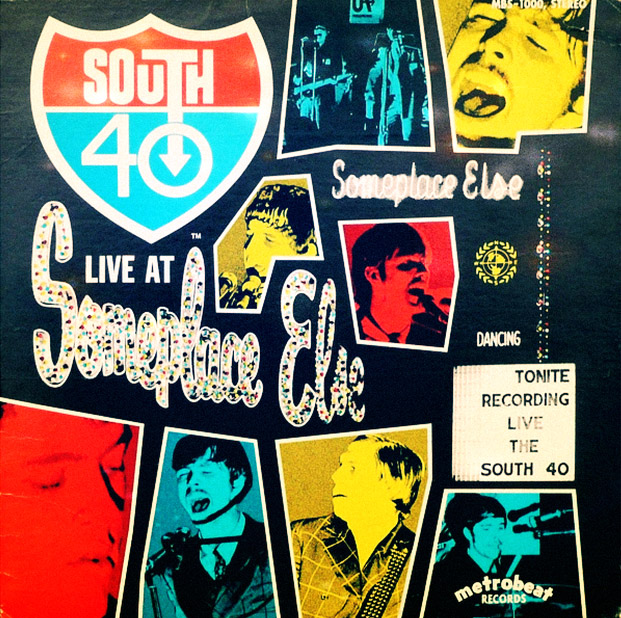
The album contained 10 songs, including cover songs and originals. 2,000 albums were pressed and all copies were sold. I did not get one, as I was 11 years old…
The lineup of the South 40 was David Waggoner on lead vocals; Larry Wiegand on bass guitar and vocals; Dick Wiegand on lead guitar and vocals; Kink Middlemist on guitar, keyboards and vocals, and Harry Nehls on drums and vocals. With personnel changes, the South 40 would soon become Crow.
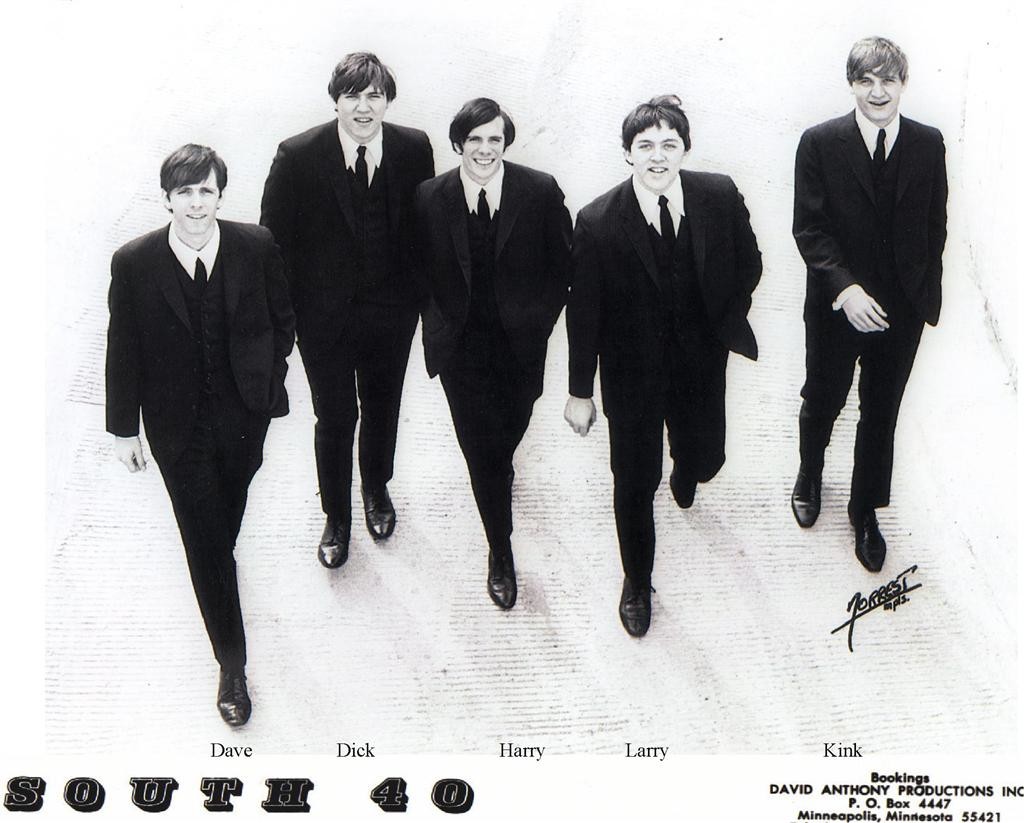
Photo of South 40 courtesy minniepaulmusic.com
TROUBLE
In about March 1968 the Flahertys sold the business to Arthur H. Lund, a 53-year-old retired executive of Campbell-Mithun Advertising Agency. It was unclear why he bought the business, although he did mention that he had four children between the ages 13 to 19. He didn’t like rock ‘n’ roll, though, and admitted to hiding in the basement to avoid it. To cut costs he cut down on security, with disastrous results.
On May 10 and 11, 1968, Police from Robbinsdale, Crystal, and the Hennepin County Sheriff’s Department broke up a possible gang fight. Five people were arrested, four of whom were under 18. Police broke up a brawl on Friday the 10th. On Saturday a fight broke out outside with 150 people gathered. A floorman needed first aid. The Saturday incident started at 41st Ave. N and west Broadway. Police moved the crowd back until it was near the Red Barn, four or five blocks south.
THE END
Ever hear how one guy spoils it for everyone? On Friday, August 16, 1968, one guy did. An unnamed 17-year-old got thrown out for being drunk. He drew a pistol from a small holster attached to his belt and shouted “I’m going to shoot I really am,” according to the Police Chief. He threatened 6-8 people before firing several shots in the parking lot across the street. He hit 18-year-old Gary Hendrickson in the chest, critically wounding him with a bullet that lodged in his lung. The shooter was disarmed by bystanders before police came. He was arrested and arraigned on August 19. The Robbinsdale Police Chief said he had a rap sheet of at least 20 charges starting from when he was six years old, many for assault.
Someplace Else was suspended by the City Council for eight days at a meeting on August 26, 1968. 200-300 people showed up for the meeting, many of them teenagers. Parents wanted it closed, teens wanted it to stay open. City Manager George DeLay cited “previous trouble, which resulted in fighting, a knifing, under-age drinking, and finally the shooting.” Police Chief George Roope read a list of 24 incidents since March 16, including: “minors being drunk, fights, thefts from autos, use of false identification, clashes involving Negro and white youths, and mugging of girls by other girls.”
Reasons for the demise were thrown around.
- Although there were six officers on duty inside the building, they merely threw troublemakers out instead of arresting them. Officers said that when they did bring miscreants to the police department, the kids were just warned and let go, so they didn’t bother.
- Minneapolis policemen were hired as security but they were not deputized to arrest.
- Lund was accused of providing inadequate security in the parking lots as specifically required by the police department.
On September 3, 1968, Someplace Else was closed down for good.
IT GETS WORSE
On November 13, 1968, the Jokers Wild had been using the empty club as a rehearsal space. At about 11:30 pm, a fire started under the stage, engulfing the west end of the building. The Robbinsdale and Crystal Fire Departments fought the fire for three hours. The cause of the fire was never determined.
The Jokers Wild had left their instruments there, and lost $20,000 worth of musical equipment that they were using courtesy of Park Music in St. Louis Park. There was no insurance coverage on the equipment and Sunn Amps refused to replace the destroyed equipment after the band drove it all back to the Sunn factory in Portland, Oregon. The band switched to Custom Amps and a PA, through Park Music, but the band was not happy with the sound and decided to make a switch and go to Torp’s Music in Richfield and obtain Marshall Stacks for Denny and Lonnie (two stacks each). David Anthony bought the band a Voice of the Theater PA system with cabinets and monitors. (Thanks, minniepaulmusic.com)
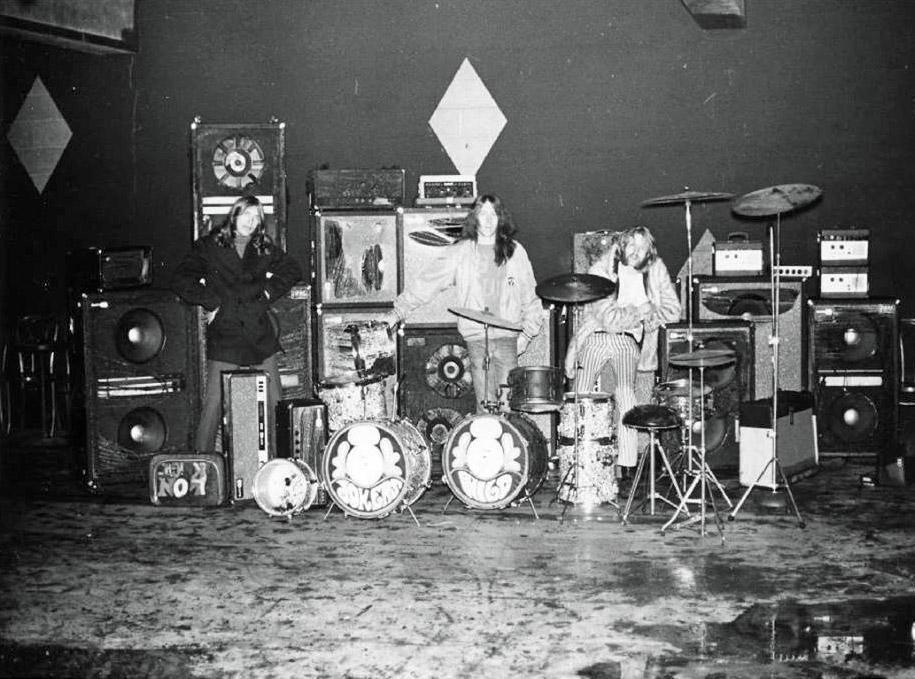
Jokers Wild photos above and below courtesy Lonnie Knight (the exasperated hippie on the right)
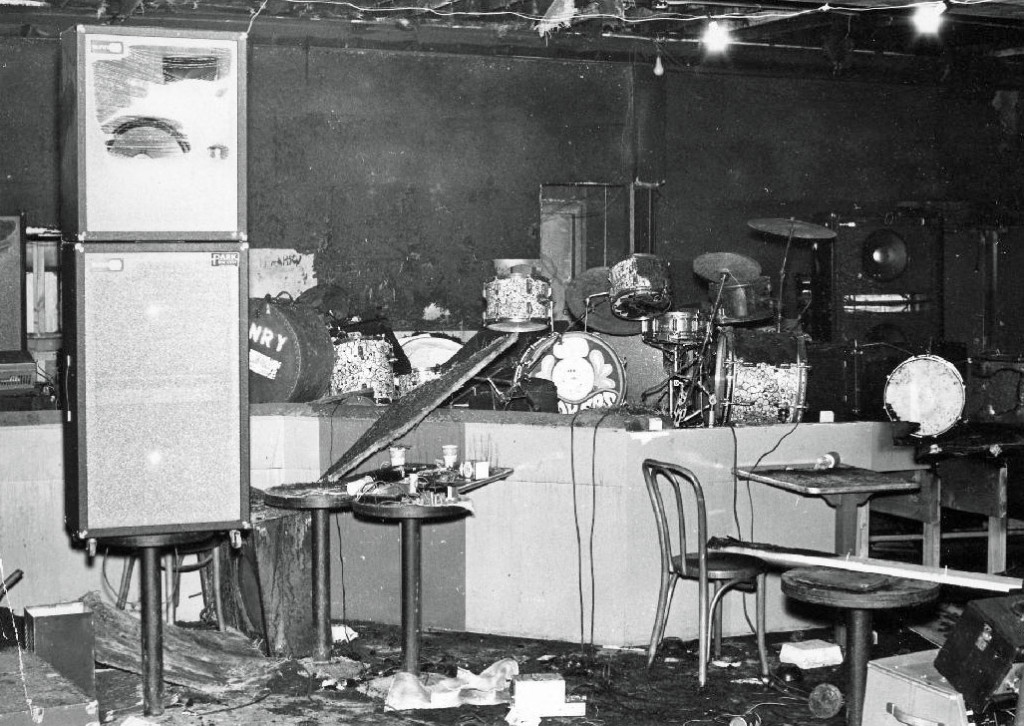
The building is still there on West Broadway. In 2015 it was Lion’s Gym.
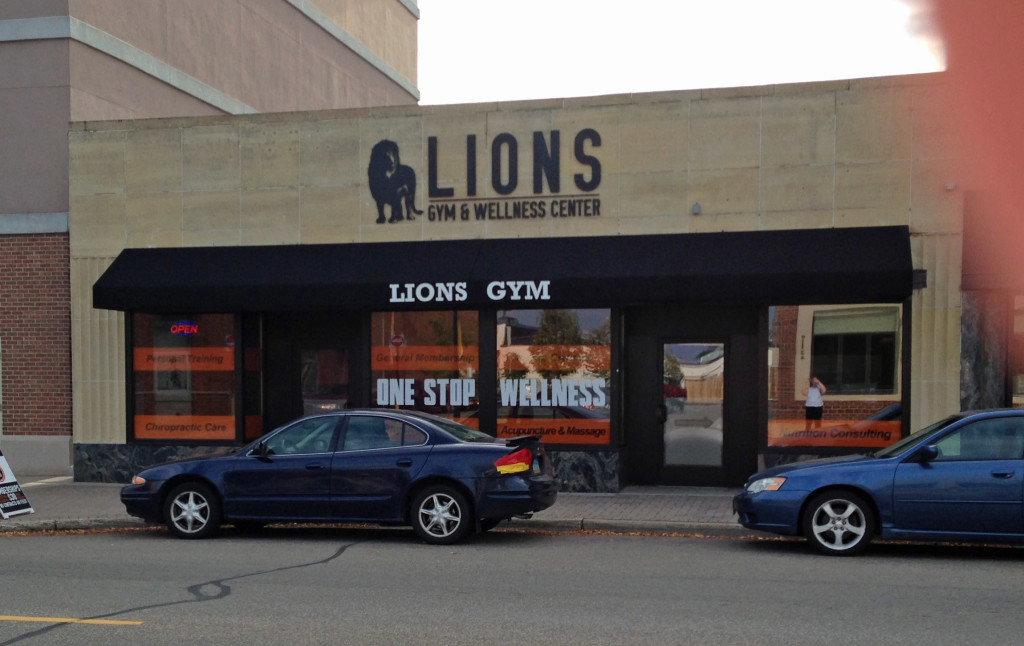
Sorry about my finger.
SOURCES
ALL of these materials were provided to me by Annette Flaherty and I thank her so much! (As happens in many scrapbooks, sometimes dates and papers are not available.)
- “‘Someplace Else’ is Appropriate Title,” Bob Bork, March 30, 1967
- “There’s Only One Sarah,” Will Jones, Minneapolis Tribune, June 15, 1967
- “Something Else’s New,” Will Jones, Minneapolis Tribune
- “Robbinsdale Studies Liquor Law Change – Council Visits ‘Someplace Else,’” Minneapolis Star, February 14, 1967
- “Sarah Vaughn Brightens New Rock Joint,” Don Morrison, Minneapolis Star, June 15, 1967
- “Strong Determination Saves Struggling Someplace Else,” Jan Erickson, September 21, 1967
- “Someplace Else” License is $1,000″
- “Night Club Setup License Discussed,” North Hennepin Post, July 6, 1967
- “Spiking Issue Set Monday,” March 9, 1967
- “Bottle Club License?,” February 16, 1967
- “Report is Rejected”
- “Night Club Owner is Bitter – Robbinsdale Takes its Lumps,” Jim Kloubuchar, Minneapolis Star, June 22, 1967
- “‘In the Heart of Robbinsdale’ Ceases to Exist,” Marnee Burnham, Robbinsdale Senior High School Robin’s Tale, September 19, 1968
- “‘Someplace Else’ Teen Club Closed,” Minneapolis Star, August 27, 1968
- “Club for Teen-agers Closed,” Marvin McNeff, Minneapolis Star, September 4, 1968
- “Robbinsdale City Council to Study Teen Center”
- “Gray Flannel to Underbeats – Ad Executive Opens Teen-Age Club,” Minneapolis Star, March 21, 1968
- “Weekend Trouble Handled,” May 16, 1968
- “Teen Center ‘In Trouble’ After Shooting?” North Hennepin Post, August 22, 1968
- “Capacity Crowd Hears South 40 Live Recording Session,” Connie’s Insider, March 30, 1968.
- “Someplace Else,” The Music Scene, June 1967
- “33 Volunteers Fought Blaze, and Cause is Still Unknown”
- minniepaulmusic.com
Please see Lee and Eddie’s.
See the Purple Barn.
The South of the Border Bar was located at 1327 Washington Ave., opening date unknown. It was owned by Henry Leonard “Hank” Sabes of St. Louis Park.
The history of the South of the Border and the Key Club are intertwined, although it appears that the entertainment took place at the Key Club.
After Sabes lost the bars (see Key Club) South of the Border became the Inn-Tuition.
The South Side Auditorium was located in a building variously known as 311 12th Ave. So., or more formally by the City as 1201-05 3rd Street So. in Minneapolis. It was usually just described by its location at the intersection of 3rd Street and 12th Ave., and I thank Jeff Neuberger for helping me sort out which corner that was.
THE BUILDING
This was one of the City’s older buildings, built in 1888 at a cost of $45,000 (one account said $52,000) by the Normanna Corporation. A stipulation written into the Articles of Incorporation of Normanna was that to be a stockholder, one must be a Norwegian by nativity or lineage, or shall have been a Norwegian citizen, or speak the Norwegian language, and must be a resident of Minneapolis or vicinity. (Minneapolis Tribune, January 31, 1886)
The footprint of the building was 66 ft. along Third Street x 118 ft. along 12th Ave. It was made of brick and stone, four stories high with a basement. There were to be stores on the Third Street frontage, and a gymnasium for the “Norwegian Turner Society.” The Hall was located on the second and third floor, and was to be one of the “principal features of the edifice.” On the fourth floor were the club rooms, reserved for the members of the Normanna Society who had contributed to the building fund. These rooms included a club parlor, reading room, dining room, stage, storeroom, and stage loft. The cornerstone was laid on August 18, 1888, with the customary speeches and a parade. (Minneapolis Tribune, August 19, 1888)
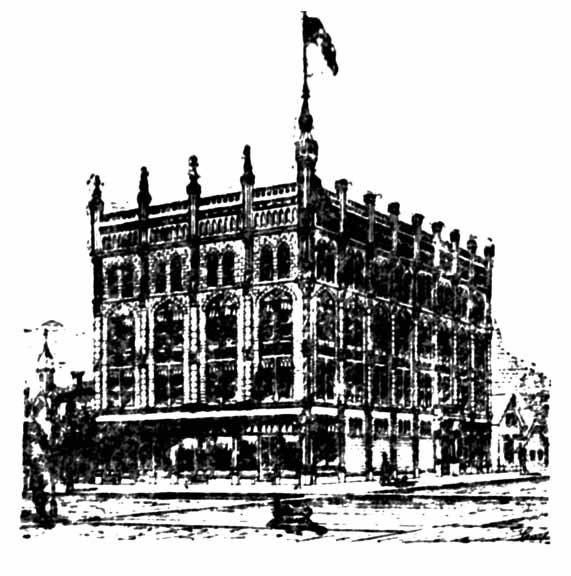
Normanna Hall preliminary sketch. Minneapolis Tribune, August 19, 1888
In 1894 the building was foreclosed on by the Northwestern Mutual Life Insurance Co. of Milwaukee, which held a $40,000 mortgage.
In 1908, NMLI sold it to the American Bank Protection Company for $25,000. The company made devices to prevent banks from being robbed. At that time, the name of the company was changed to O.B. McClintock, but was still referred to by its previous name.
Although it was called an auditorium, and it did host meetings, speeches, boxing matches, etc., it appears that most of its activity was more of that of a ballroom. And the owners of the venue were very liberal when it came to who they rented it to. In particular, it was one of very few venues that the black community could rent for their dances, which was important since they were not welcome at downtown nightclubs.
PAPER DRESS DANCE
The first event mentioned at the South Side Auditorium (SSA) in the Minneapolis Tribune was a “Paper Dress Ball,” in which all the women would be wearing dresses made of the colored newspaper supplements of the Tribune – yellow, red, pink, and green. The dance was given by the South Side Dancing academy, the “high life” department of the the Twin City Colored Waiters’ union. The group was described as the “Dusky 400,” and their leader and master of ceremonies for the dance was George Washington Tyler. The feature of the affair was to be the introduction by Prof. A.C. Irvin of the latest dances from gay Paree, including the Imperial Gavotte, the Delagrade Flirtation Waltz, and the Cream City Minuet. “‘Law, you ought to see the way that boy takes with the girls,’ says George Washington Tyler.” (Minneapolis Tribune, November 29, 1909)
THE SWITCHMEN’S DANCE
In 1910 the Railroad Switchmen were on strike, and had used the SSA as a meeting place. Regardless of these tensions, the Switchmen’s Dance at the SSA on February 21, 1910, was a big success. Nearly 5,000 tickets were sold, and attendance was the largest ever at the SSA. Labor leaders were in attendance. (Minneapolis Tribune, February 27, 1910)
STROM AND BRUNZELL
According to an anniversary article from 1928, Hans Strom and Herbert Brunzell (both spelled many different ways in the paper) became the proprietors of the SSA on April 15, 1911. (Minneapolis Star, April 14, 1928)
JAIL BAIT PART I
Policewoman Miss Emilie Glorieaux pulled four underage girls, no older than 16, from a dance at the SSA, and stashed them at the Central police station as witnesses against the men in charge of the dance: Hans Strom, Herbert Brunzell, and Henry Grafstrom. Strom was fined $25. (Minneapolis Tribune, September 11, 1911)
JAIL BAIT PART 2
An article from 1912 tells us that Hans Strom was the proprietor of the SSA, and that he was fined in municipal court for allowing minors in the hall. It was the second fine imposed on Strom in six months, and the judge doubled the amount of the fine to $50. Policewoman Miss Emilie Glorieaux told the judge that of 500 or 600 dancers there one Sunday night, fully 100 of them looked to be under age. She arrested three girls. Strom pleaded guilty. Arrested with Strom was Herbert Brinzell (sic), but he was dismissed, as Strom testified that Brinzell no longer had an interest in the hall. This was probably a lie. (Minneapolis Tribune, March 15, 1912)
EJECTED TANGOISTS GET $15 WORTH OF REVENGE
By 1915 the SSA was managed by Strong and Brunzell. This couldn’t be a variation of Strom and Brinzell from the story above, could it? Anyway, in this story, two men became boisterous while tangoing about the floor and were ejected from the hall. They returned and demanded the return of their entrance fee. The ticket seller refused, but one of them stuck his arm through the window, scooped up $15 (the receipts for the night), and they both fled. (Minneapolis Tribune, June 28, 1915)
In February 1919, Little Johnnie’s full orchestra provided the music for dancing.
On October 10, 1920, fire broke out on the fourth floor, while about 200 dancers were doing the one-step below. A sprinkler system went on, the fire was quickly subdued, and the customers went home wet but safe. The American Bank Protection Co. had its paint shop above the hall, and incurred about $5,000 in damages. Evacuation of the building went on “without hysteria.” (Minneapolis Tribune, October 10, 1920)
NORTHWEST BULLETIN
There were many ads for dances in the Northwestern Bulletin in 1922 and 1923. The Northwestern Bulletin was an African-American weekly newspaper that was published out of St. Paul from 1922 to 1925. I have collected several of these ads and will post some of the most interesting.
For the Entertainers Spring Ball below, music was provided by Moore’s Jazz Orchestra. William W. (Bill) Moore was a bandleader who was very busy in the 1920s, and could assemble an orchestra of any size for any occasion. From the ads I’ve seen, he must have been the top bandleader of the time. At this dance, the band was joined by Louis Sklar, “Famous Saxophone and Clarinet Player.”
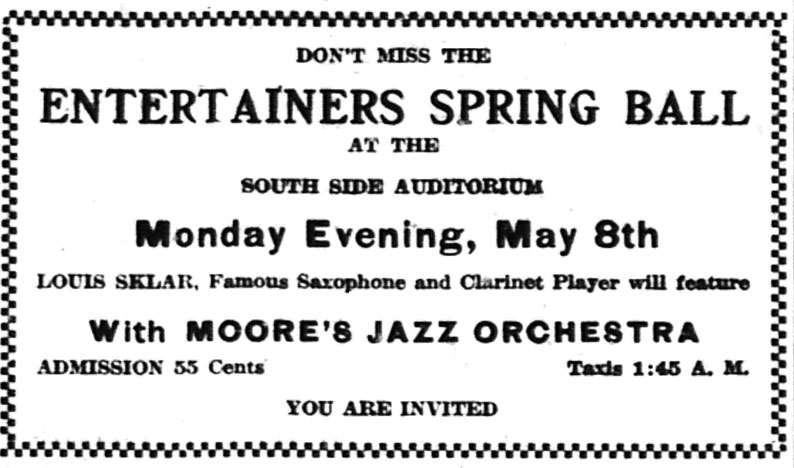
Northwest Bulletin, May 1922
BELLHOP DANCE
These were fine times when all of the trades got together and had annual dances, customers be hanged. And such was the case with the bellhops of Minneapolis on August 16, 1922, when they held their annual ball at the SSA. A colorfully-written article suggests some new dances for the bellhops to learn. And this:
Guests at the hotels will have to wait on themselves tonight – and if the service is satisfactory give themselves a tip. No bellhop will dash into the lobby to confiscate the baggage of the incoming traveler or lead him up to his sixth floor room or answer his petulant punches of the call bell. The magii (sic) of the hostelries will be busy tripping the light fantastic toe elsewhere.
(Minneapolis Tribune, August 16, 1922)
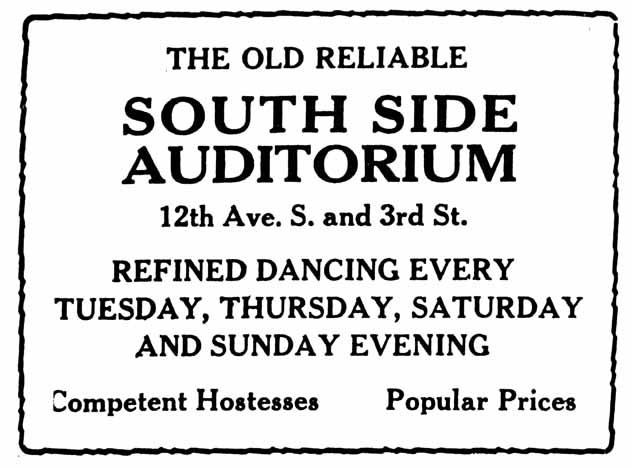
Minnesota Daily Star, April 19, 1923
An article in the Northwestern Bulletin dated September 8, 1923, squelched a rumor that the venue would no longer be made available for dances by and for the black community. Bandleader Bill Moore “got in immediate touch with the management and convinced them that the major portion of the Twin Cities people were not of the rowdy element. Re-assured of the proper conduct, the manager again promised the hall under proper conduct.”
THE CLEF CLUB
The Clef Club was a nightclub located in the Kistler Bulding on Sixth Ave. No. They would schedule many dances at the SSA, many with themes or around the holidays.
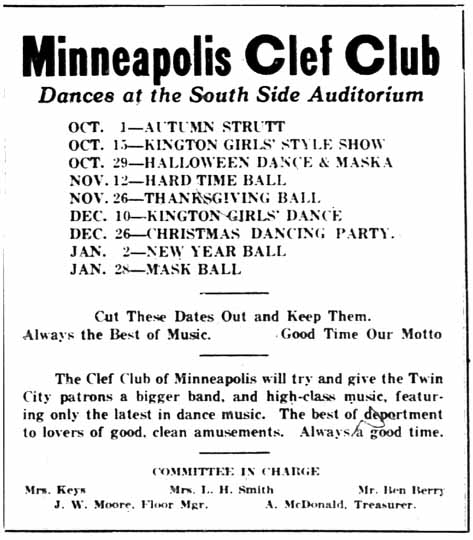
Northwest Bulletin, October 1923
JAZZ HOUNDS
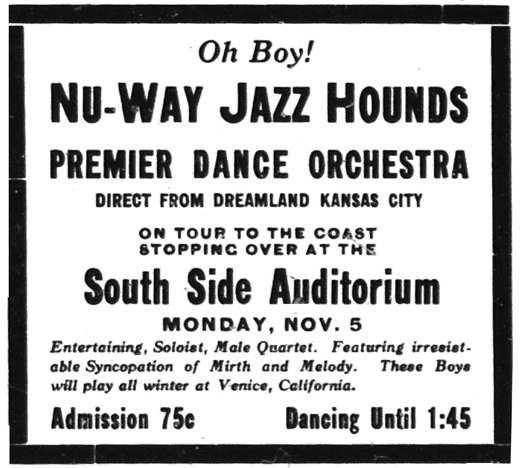
Northwest Bulletin, November 5, 1923
TURKEY TROT
This Thanksgiving dance – Turkey Trot and Sweet Potato Roll – introduced the novelty dance “The Balloon Strut” and gave away two live turkeys! It was a Clef Club production, with Bill Moore’s Town Talk Band on for entertainment.
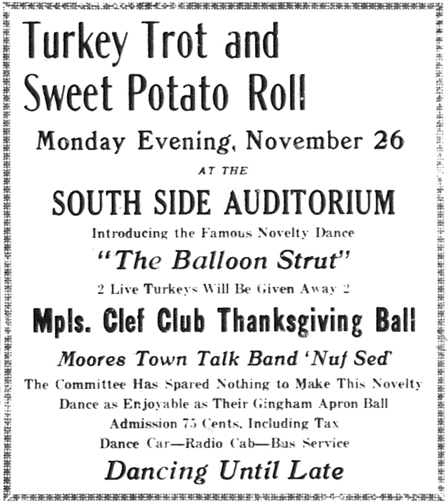
Northwest Bulletin, November 1923
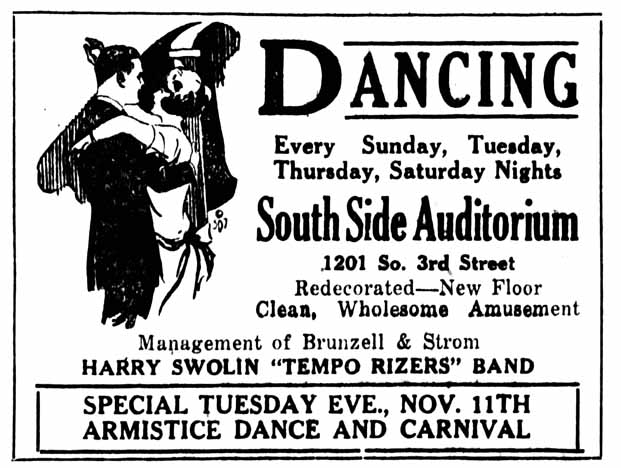
Minneapolis Star, November 8, 1924
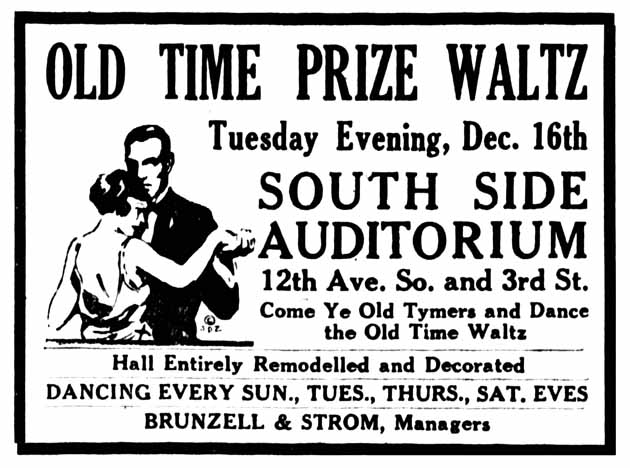
Minneapolis Star, December 13, 1924
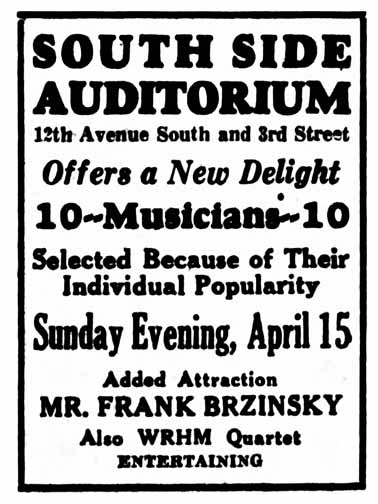
Minneapolis Star, April 7, 1928
17th ANNIVERSARY
An article from 1928 states that the SSA will celebrate its 17th Anniversary with a special program. Still proprietors after 17 years were “Bunzell and Strom.” Nobody can spell. Correct me if I’m wrong, but that brings the beginnings of the SSA to 1911, and we know that it was in operation going back to at least 1909. Maybe they mean when Strom and Brinzell/Brunzell/Bunzell took over management. (Minneapolis Star, April 14, 1928)
TROUBLE BREWING
The dance hall license committee balked at renewing the license for the SSA in May 1928 “because of complaints made against it.” It was eventually renewed.
January 1, 1929, opened with ads in the Minneapolis Tribune for “American” music on Sundays, and music by Herbert Brunzell’s Orchestra on Thursdays and Saturdays.
In between a lot of Scandinavian dances, there were:
The Night Owls, Colored musicians from Omaha, were scheduled to play at the SSA on May 5, 1929.
The Dixie Ramblers Band, also from Omaha, came to the SSA on May 19, 1929.
THE DEPRESSION
There is a gap between September 11, 1930 and December 1931. The three ads in 1931 are “Bargain Dances,” admission 10 cents, playing old-time American music, to introduce you to the beautiful SSA.
Hans Strom was evidently out, as his name is seen as the manager of the Minneapolis Coliseum in 1931. He died in June 1950 at the age of 69.
THE END IS NEAR
Ads above give admission prices of 55 cents to 75 cents in the early 1920s, but the coupon below from 1932 represents a cut in cost, undoubtedly a factor of the Depression and an increased competition for customers among all the ballrooms in town.
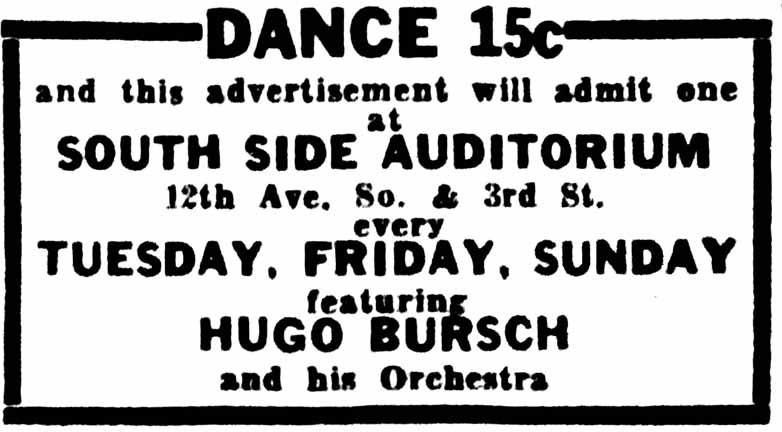
Minneapolis Tribune, February 5, 1932
EVERYONE WELCOME
The SSA was a meeting place for all sorts of groups, including many union and political groups in the politically-charged days when many trades were unionizing, and during the Depression years when Communism started to look like a good alternative to some people. On November 4, 1934, a Communist rally was held at the SSA before the 1934 election. This is interesting because at the Labor Temple, there was some picking and choosing about what groups could rent the space. Apparently there were no judgements here.
Below you can see that the cost has dropped from 15 cents to 10 cents, reducing income even further in an attempt to draw customers.
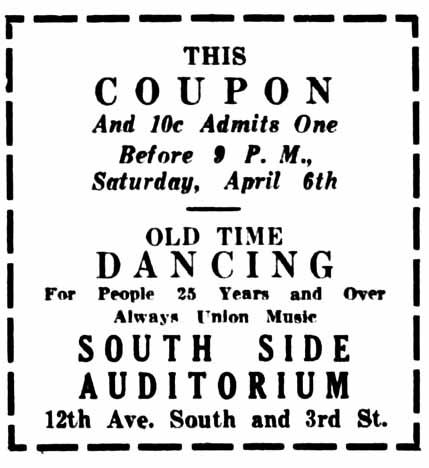
Minneapolis Star, April 5, 1935
TICKET TAKER SLUGGED
There must have been a dance on October 4, 1936, because the ticket taker got slugged (their word, not mine) by a guy who was refused admittance. You read it here. (Minneapolis Tribune, October 6, 1936)
The Bakers Union had their annual Thanksgiving Eve dance at the SSA on November 25, 1936.
END OF THE SOUTH SIDE AUDITORIUM
It appears that the hall was no longer used after 1939. Competition among the many other ballrooms was stiff, and the Depression took disposable income out of people’s pockets. The last ad I found was this one:
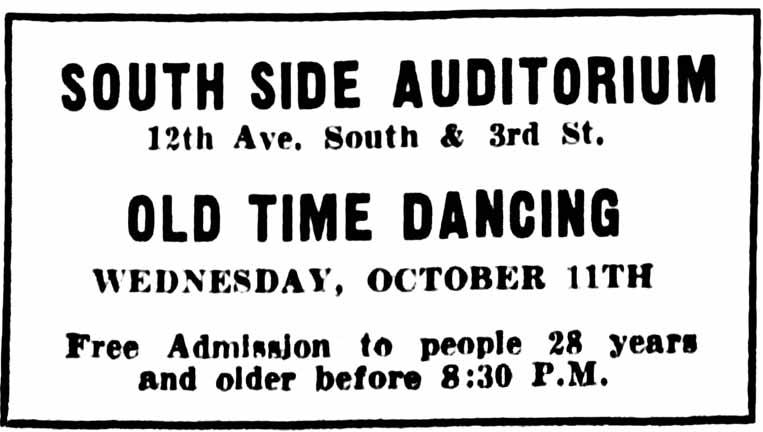
Minneapolis Star, October 10, 1939
In the 1940s the building was used by a surplus company. Finally in July 1967, the building was taken by eminent domain for the construction of some crazy loop at 35W and 4th Street.
The Southside Night Club (also called the Southside Bar) was located at 212 – 11th Ave. So.
THE BUILDING
Usually these building histories aren’t that interesting, and the page for the time we’re looking for is actually missing, but this time it’s pretty good!
The permit record from the City of Minneapolis generally gives the action the permit is for (building, repairs, demolition, etc.) and often but not always the building’s use (residential, factory, store, etc.)
The building was built as a 42 x 80 brick and stone apartment building (“flats”) in December 1890 at a cost of $12,000. In 1899, electricity was added to what was called a “Sporting Hse.” Four days later, a similar entry was made for electricity for electricity for “Hse. of Ill Fame.” I’ve never seen that before on a permit card! From 1903 to 1907 it is called a dwelling, then a Hotel. In 1929 it is a Rooming House, but two days after it’s a Rooming House, altered to a Factory? In 1931 it’s altered to a Cafe, as it is in 1932. Of course, 1932 to 1942 are missing!
SOUTH SIDE NITE CLUB
It must have become a beer tavern with the end of Prohibition, sometime soon after April 1934. It was reported to be a “black and tan” place with a 3.2 beer license belonging to Bert “Dutch” Thompson. That means it was open to both black and white clientele.
In 1935, the Minneapolis Spokesman included it in a story about about an order given to nightclub owners to cater to only one race or another. The charge was apparently unsubstantiated.
AGAIN A HOUSE OF ILL REPUTE
The club was in the news again on January 6, 1938, when Dutch, the doorman and the cashier were jailed when the club was raided at 3 am by 20 policemen, 10 deputy sheriffs, and members of the Hennepin County Grand Jury. 40 customers were in the Club at the time of the raid, but they were not detained. (Minneapolis Star, January 6, 1938)
The next day all three prisoners were found guilty: Dutch was ordered to pay $75 or serve 30 days in the Workhouse for operating a disorderly house. Gladys and Nick were sentenced to $25 or 20 days for being found in the place. Fines were paid. (Minneapolis Star, January 7, 1938)
On January 10, 1938, all of the the club’s licenses were revoked, throwing 22 people out of work.
The license was transferred to Minneapolis artist Otis Sheldon, reported the Spokesman. That didn’t work out; on April 14, 1939, it was reported that Dutch was forced out and “a new ownership is reported operating the place now with all-white personnel for the first time in 20 years.” Dutch denied he was forced out and said that poor business and poor service from employees were the reasons for closure. “Thus passes from the Twin night club scene the famed Southside and 13 people [employees] are ‘walking the street.'”
Not only does the building still stand, it’s gorgeous! And if these bricks could talk!
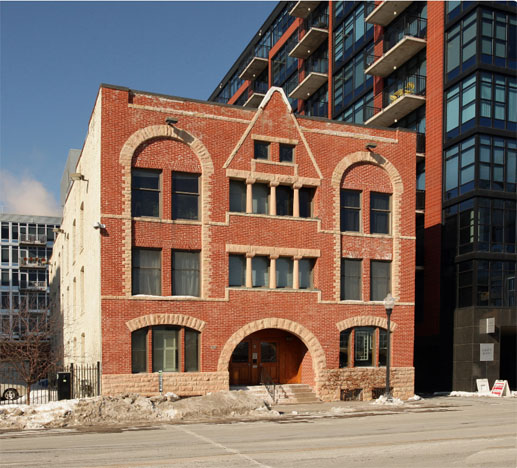
Spanish Villa was on Rice Street and Little Canada Road, St. Paul, in June 1932. Owned by Tommy (Fatty) Woods. Orchestra entertainment every night – Dine & Dance.
474 Wabasha, St. Paul. 1888-1928, at least. In 1928 the home of Alexander and His Ragtime Band.
Sperling’s Tavern was located at 560 University W. (at Dale) in St. Paul.
These photos from the Minnesota Historical Society were apparently in a collection associated with Ira Pettiford.
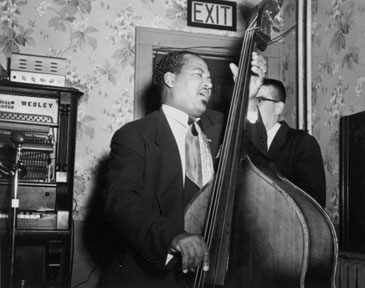
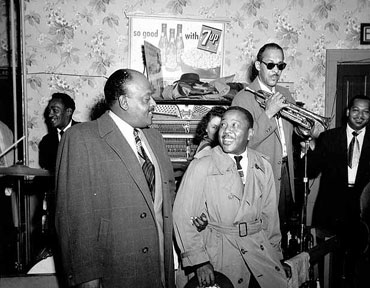
Unfortunately, the site is now the location of the inevitable dollar store.
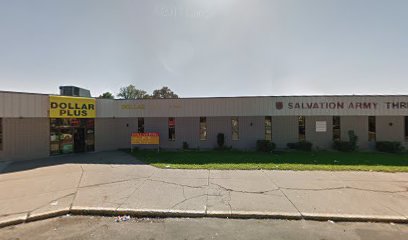
355 NE Monroe, Minneapolis. 1973 country venue.
400 E. Hennepin Ave., Minneapolis. Folk venue, owned by two Johnson Brothers. Became Whitey’s.
“St. Louis Park High School also had music,” remembers Owen Husney of the High Spirits, who was himself from the Park. “I first saw Koerner, Ray, and Glover there in ’63 in the auditorium.. The Chancellors, High Spirits, Novas, etc. all played dances there on Friday nights. It was the place to play.”
This sixties venue was on Main Street in the town of St. Michael, and would host teen dances in the ‘sixties, drawing crowds from all over what we term the “exurbs” of the Twin Cities today.
Don Hastings from Osseo remembers,
Fights used to get out of control there. One night they had the fire department come and hose down the crowd on the sidewalk, believe it or not.
Sounds like a typical Saturday night to me! Thanks for the tip on this new venue, Don!
389 North Exchange. Site where many black R&B and rock ‘n’ roll acts performed in the 1950s.
This page will attempt to sort out the different venues owned by the City of St. Paul created to host civic events. They include:
- The St. Paul Auditorium
- The St. Paul Auditorium Addition
- The St. Paul Auditorium Theater Section
- Stem Hall
- The St. Paul Civic Center
- The Roy Wilkins Auditorium
Information for this page came from Wikipedia, photos on the Minnesota Historical Society database, the RiverCentre website, and a search of the Minneapolis newspapers. All comments, additions, photos, and corrections are welcome; please feel free to contact me.
THE ORIGINAL ST. PAUL AUDITORIUM: 1907 to 1982
The original St. Paul Auditorium was built in 1907 and razed in 1982. Like the Minneapolis Auditorium, it had a huge pipe organ, which was sold to the Old South Church in Boston.
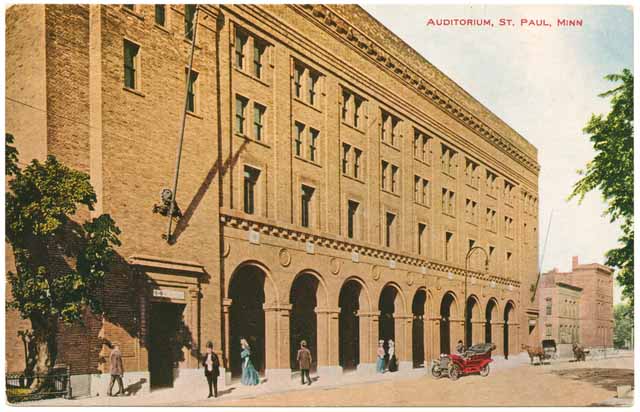
Original St. Paul Auditorium, 1910. Image courtesy Minnesota Historical Society
ST. PAUL AUDITORIUM (ADDITION): 1932 to 1985
The St. Paul Auditorium addition was built in 1932, at 175 W. Kellogg Blvd., adjacent to the original Auditorium. It was designed by renowned African American municipal architect Clarence W. Wigington.
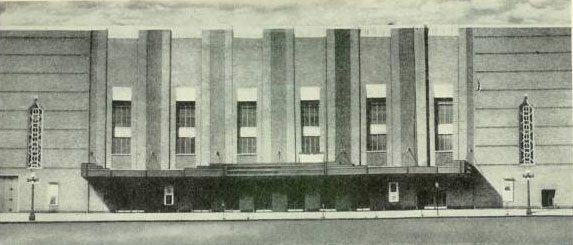
St. Paul Auditorium Addition
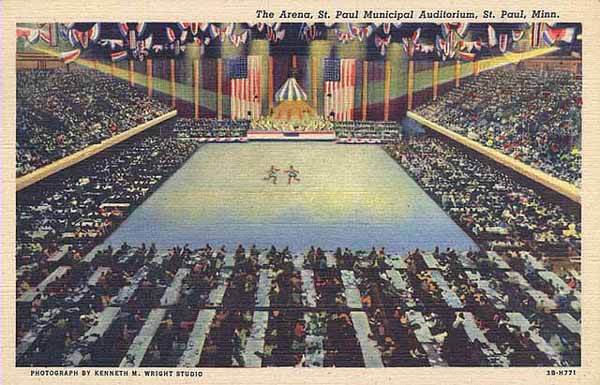
Inside the auditorium, 1940. Courtesy Minnesota Historical Society
In 1970, when the building that would become known as the St. Paul Civic Center (see below) was still in its conception stage, ads began calling the St. Paul Auditorium the St. Paul Civic Center. For a while they seemed to be interchangeable – the Jimi Hendrix concert in May 1970 was advertised at both places. On January 4, 1971, Minneapolis Star Outdoor Writer Joe Henessey, when reporting on the first annual Minnesota International Sports, Boat, Camping, and Vacation Show, helpfully says that it will be at “the St. Paul Civic Center (formerly Auditorium).” When that change was made, I didn’t catch. For the record, John Gilbert, the Tribune’s hockey reporter, confirms that the Civic Center did indeed open on January 1, 1973, in his column the previous day, so this naming business is a bit mysterious. What happened when the REAL Civic Center opened? Did the St. Paul Auditorium go back to its original name, or leave us to guess just where some concerts were in St. Paul after about 1970?
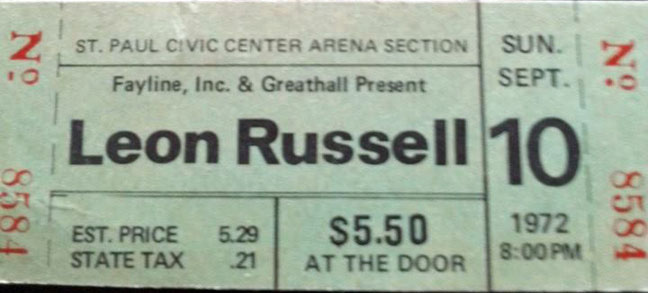
See?? Image courtesy Jim Froehlich
In 1985 there was no more St. Paul Auditorium when it was renamed the Roy Wilkins Auditorium (see below).
ST. PAUL AUDITORIUM THEATRE: 1932 to about 1980
One new venue included in the addition was the St. Paul Auditorium Theatre/Theater/Theater Section. As its name suggests, this space was mostly dedicated to plays – often traveling musicals. It also hosted ballets, operas, and concerts.
Some non-theatrical entertainment presented at the Theater included:
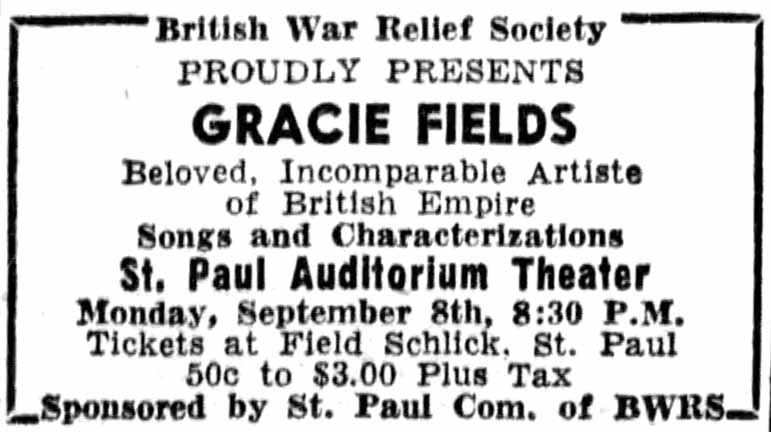
1941
Stan Kenton with June Christy appeared at the Minneapolis Auditorium Concert Bowl on November 12 and the St. Paul Auditorium Theater on November 13, 1951.
April 29, 1956: Grand Ole Opry, 3:00 and 8:00
May 13, 1956: Elvis played a matinee show here before going over to the Minneapolis Auditorium for an evening performance. See details Here.
November 10, 1957: Jazz for Moderns

October 26, 1958: Louis Armstrong’s performance was booked by promoter Pat Black when he discovered that Armstrong would have a few days between finishing a movie in Hollywood and opening at the Copacabana in New York. He would be accompanied by his usual sidemen: Trummy Young on trombone, Peanuts Hucko on clarinet, Billy Kyle on piano, Danny Barcelona on drums, Mort Herbert on bass, and Velma Middleton. (Will Jones, Minneapolis Tribune, October 21, 1958)
February 22, 1960: Frankie Avalon, backed by the 15-piece Billy Williams Orchestra, made a 2:00 appearance at the Minneapolis Armory and an 8:00 show at the St. Paul Auditorium Theater.
May 19, 1961: Odetta
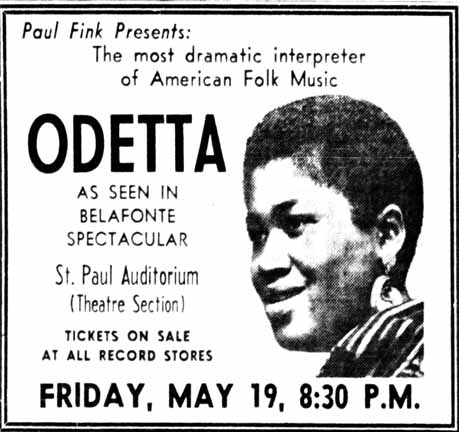
1961
July 9 to 13, 1963: Harry Belafonte
March 7, 1964: Allen Sherman
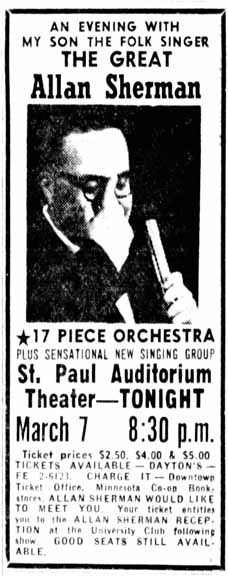
Ray Charles performed at the St. Paul Auditorium Theater on October 9, and the Minneapolis Auditorium on October 10, 1964.
On November 19, 1966, the Dave Brubeck Trio appeared at the Theater.
The musical “Hair” was booked at the Theater from February 23 to March 7, 1971, and so many ticket requests had to be returned that a repeat performance that May. It was the first show ever to be brought back to the Twin Cities for a second run in the same season.
They also started showing special events on closed circuit TV, such as the 1970 Indianapolis 500. And this:
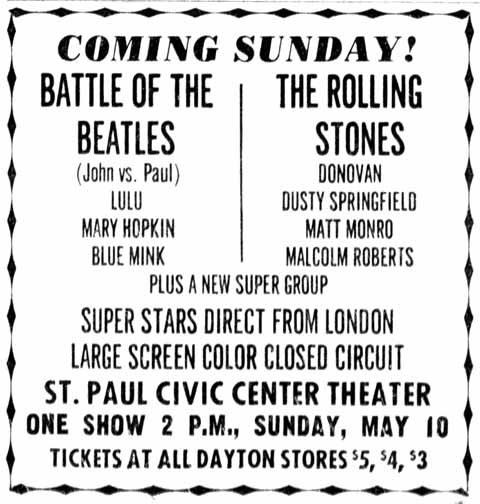
1970
Poco and a “special performance” by Shawn Phillips came to the St. Paul Auditorium Theater on May 21, 1971.
Edgar Winter was at the St. Paul Auditorium Theater on February 16, 1973.
The last mention I found in the Minneapolis papers was in November 1978.
STEM HALL: 1932 to about 1980
Stem Hall was another new venue added in 1932, smallest of the three spaces in the building, holding a little over 1,000 people. This picture of Manuel and Dorothy Aguirre dancing at Stem Hall in 1964 shows the inside.
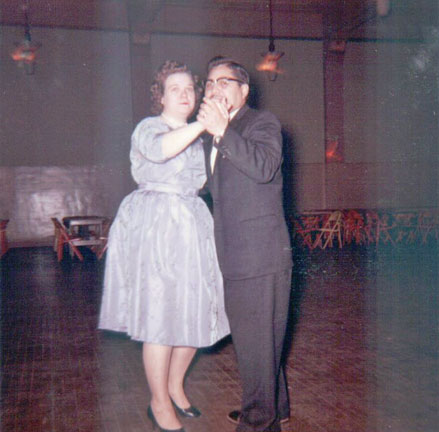
Photo courtesy Adrian Aguirre
Stem Hall was heavily used for boxing and wrestling matches, lectures, antique shows, poultry and other animal shows, majorette contests, and some concerts.
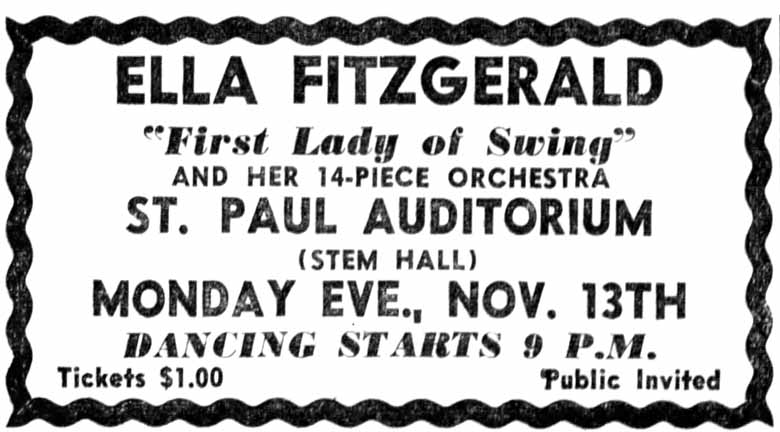
1939
Little Old Lady Blows Up Stem Hall
During World War II, Stem Hall (along with the YMCA and YWCA) hosted “Swing Shift Dances,” presumably for people to while away the time between their job shifts. Well, a little old lady named Miss Elizabeth Flynn was irked that these folks should be home taking care of their children, so she wrote a letter threatening to blow up the sites of these dances, including Stem Hall. She confessed that she didn’t know how to blow up buildings, but just wanted to scare people into doing something about the problem. “I thought maybe they’d think I was a big gang of outlaws and do something.” (Minneapolis Tribune, June 19, 1943)
A dance honoring four black baseball players, Jackie Robinson, Roy Campanella, Roy Doby, and Satchell Paige, was held at Stem Hall on October 30, 1948, sponsored by the Harlem Jive Club. (Minneapolis Star, October 29, 1948)
Black Muslims at Stem Hall
On May 17, 1964, “members of two Twin Cities black Muslim sects” met at Stem Hall after a protracted discussion by the St. Paul City Council, the owners of the St. Paul Auditorium. Because the group was in favor of black separatism, and the City was worried about racism – or reverse racism, since whites would not be welcome. The meeting was attended by 100 of the “American so-called Negro,” as referred to by main speaker Louis Shabazz (Louis X), Muslim leader from Boston. Everyone was thoroughly searched by “members of the sect,” including the approximately 20 white journalists on hand.
The message of the meeting was that the American government would eventually give Negroes land of their own, because “the government does what is expedient.” If not, God will intervene, and “it will be very, very, very serious and very painful.” Minneapolis Tribune reporter Irv Letofsky wrote a very detailed article about the meeting and the group’s ideology on May 18, 1964.
Little Richard and his Royal Comany appeared at Stem Hall on November 11, 1964. Also appearing were The 4 Ts, Larry Lasters, and the Great Malcolm Hayes.
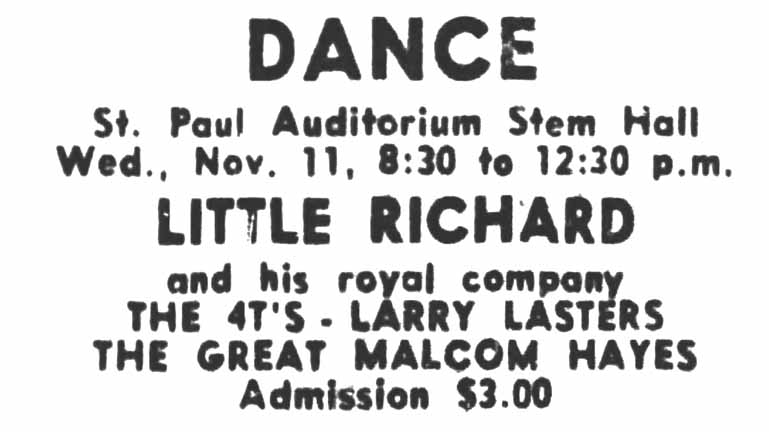
1964
TRAGEDY AT STEM HALL
On August 30, 1968, a concert and dance was held at Stem Hall, emceed by Jack Harris, a/k/a disc jockey Daddy Soul on radio station KUXL. Performers included:
- Syl Johnson
- Maurice & Mac
- Willie Walker and the Exciters
- Maurice McKinnis and the Blazers
These groups were well known in clubs like King Solomon’s Mines where Soul music was a staple.
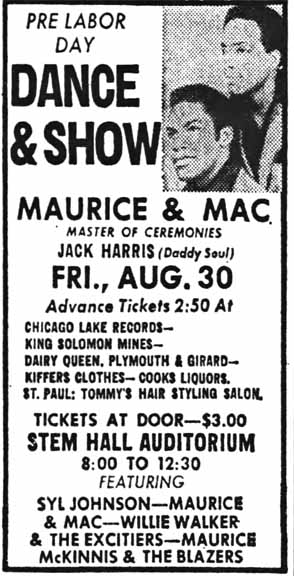
1968
What should have been a fun night turned into two nights of fear, anger, and violence – not only because of a situation handled poorly but because of underlying conditions that faced black communities all across the country.
The facts, as reported in the newspapers and in investigative reports approximate these. About 350 young people, mostly black (I’ll use that word instead of the word Negro used at that time) were in attendance. One young man was in a rest room with some others who were drinking, and he flashed a gun. It was never clear whether he used it or even who he was. Two off-duty policemen who were hired for the event came on the scene and took the gun away from him and tried to arrest him. They were attacked by about 20 men who tried to retrieve the gun. The policemen called for backup and the melee started. A gunshot was heard and a policeman was hit in the arm or hand. The shooter was never identified.
At that point, having lost the opportunity to peacefully arrest the young man, the police decided to use nightsticks to bar the door to the hall, keeping the people in. They broke through one of the doors, and then the police decided to keep them back by lobbing teargas into the crowd. Thus incited, the crowd began yelling invectives at the police and throwing furniture at them. Once outside the missles became rocks. Mob violence ensued and the car of KSTP-TV newsman Dave Margeson was smashed by rocks and a piece of wood; he was treated and released from the hospital. The crowd moved west down 4th Street, smashing store windows, until they got to the Selby-Dale neighborhood, where many of the City’s 10,000 black people lived in what could only be described as a ghetto. The disturbance was considered contained by 2:30 am.
Seven people were arrested the first night. Two of them, a married couple, were from Minneapolis, and they had a loaded submachine gun in the trunk of their car and a .45 pistol under the seat. Whether this was related to the disturbance was not quite clear.
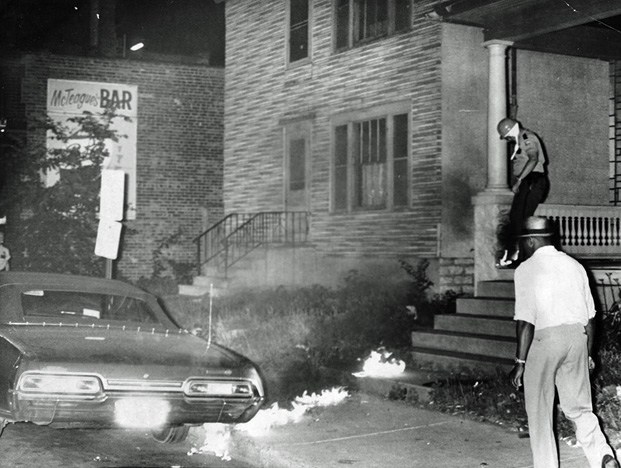
636 Selby Ave. Photo courtesy Jeff Neuberger
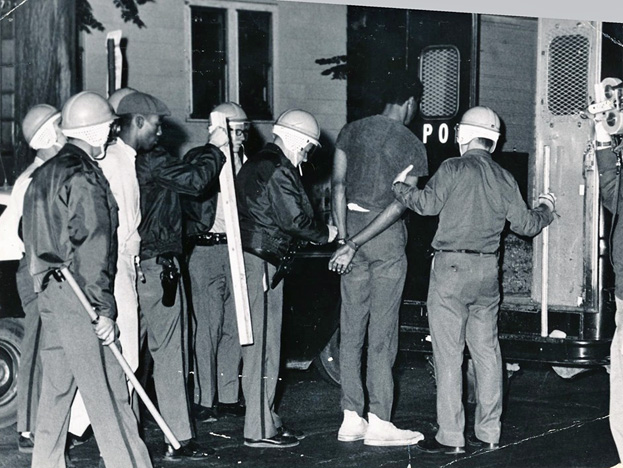
Selby and Avon Streets. Photo courtesy Jeff Neuberger.
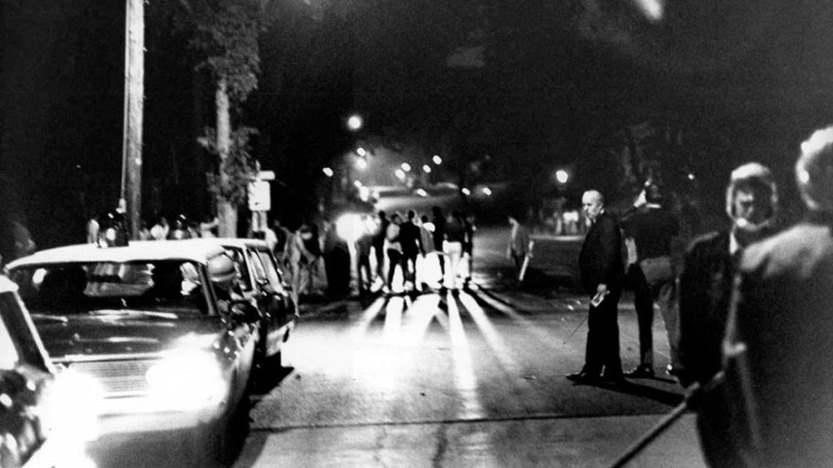
Photo courtesy St. Paul Police Historical Society
The next night, violence continued on its own momentum. At about 9:30 pm, someone with a shotgun wounded three police officers who, with about 20 others, were trying to break up a crowd of about 200 who had gathered at the site of a firebombing. A police command post was set up at the St. Paul Cathedral, and two-man tear gas units were sent around, with police at every intersection. Cars were prevented from coming into the area from Interstate 94 at the Dale Street exit. Four businesses were fire-bombed and fire trucks were met with sniper fire but no one was injured. Ten people were arrested, most for carrying firearms. Two white youths from upstate Minnesota were arrested in a house when spotted brandishing a shotgun on a balcony.
In the wake of the incidents, a committee was formed by the St. Paul Urban Coalition to investigate them. Sixteen pastors gathered to support this action and expressed their concern that the investigation be impartial and representative. The St. Paul Urban League and the St. Paul Human Rights Department also launched their own investigations. Meanwhile, the Mayor and others defended the actions of the police and laid the blame squarely on the “mob.”
The report by the St. Paul Human Rights Department, released in February 1969, placed the blame for the disturbances mainly on how the police handled it. While their job was to arrest one man with a gun, they instead barricaded the door of the hall with their night sticks and used tear gas to subdue the crowd. An underlying cause was said to be the overall condition of the Selby-Dale area.
The report of the St. Paul Urban Coalition, headed by Arthur S. Fleming, President of Macalester College, was released in March 1969 and echoed the first but was much more detailed and damning. The decision of the police to bar the door and throw teargas into the hall was roundly criticized. A policeman knocked down pregnant woman, pulled her hair, and threw her into a wall. A 15-year-old polio victim was smashed, face-first, into the pavement and sent home bleeding. The biggest troublemakers appeared to be a group of about 30 from Minneapolis, dressed in boots, Levi jackets, blue jeans, and cowboy or Australian “digger” hats.
And although much of the 96-page report centered on the disturbances themselves, the committee had plenty to say about “discrimination patterns in housing, education, recreation, employment, welfare, and police-community relations, and includes recommendations for improvement in those areas.”
Sources:
- Minneapolis Tribune, August 31 to September 2, 1968
- Minneapolis Star, August 31, 1968
- Minneapolis Tribune, February 2, 1969
- Minneapolis Star, February 6, 1969
- Minneapolis Tribune, February 9, 1969
- Minneapolis Tribune, February 12, 1969
- Minneapolis Tribune, March 19, 1969
- Minneapolis Star, May 7, 1969
In December 1978 Stem Hall became the new home of the Twin City Model Railroad Club
The last mention I found of Stem Hall in the Minneapolis papers was in May 1980.
See the text of a 2018 article about the Stem Hall riots at the end of this page.
ST. PAUL CIVIC CENTER: 1973 TO 1998
This part is very confusing, because concerts began to use the term “St. Paul Civic Center” or “St. Paul Civic Center Arena” long before the venue supposedly opened on January 1, 1973. A search of my own Events page shows Jimi Hendrix appearing there in 1970. Further research shows that the show was actually at the St. Paul Auditorium, but the ad, placed by Pepsi, the sponsor, did indeed call it the St. Paul Civic Center. This was at a time when the financing for the Civic Center was still being negotiated.
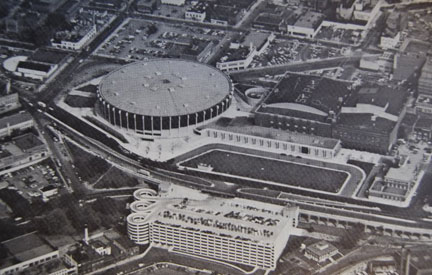
St. Paul Civic Center
The information below courtesy Vintage Minnesota Hockey:
The St. Paul Civic Center was an indoor arena that opened on January 1, 1973. It was the home of both incarnations of the Minnesota Fighting Saints of the WHA – the first from 1973-1976 and the second from 1976-1977. The arena seated 16,000.
The Civic Center is best remembered for its unique hockey boards that were made of clear acrylic glass all the way down to the ice, installed at the urging of Civic Center Director John Friedmann. In 1973 Friedmann said, “I saw them on TV during the Winter Olympics in Sapporo, Japan, in 1972, and felt those would be great for better fan enjoyment while watching hockey.” The iconic clear dashers were made by Safeway Steel of Milwaukee. “They cost us $85,000 in 1973, but would probably cost between $200,000 to $225,000 today. The arenas in Sapporo and St. Paul are the only ones in the world thought to have the clear boards,” said John Friedmann.
The seating configuration of the “Madison Square Garden of the North,” as the Civic Center became known as, was round, meaning that the closest seats at center ice were not right up against the glass. The clear dasher-boards made for better sight-lines for those spectators.
Also of note, the principal architect for the Civic Center was Len Lilyholm, who found himself right at home within the Arena as a player with the Minnesota Fighting Saints hockey club.
The last professional hockey team to skate in the Civic Center was the IHL Minnesota Moose hockey club from 1994-1996. The clear boards were replaced with normal wood boards when the Moose played there, as the professional team needed to be able to sell advertising on them. This ruined the sight-lines for what should have been the best seats, and proved that in order to get an expansion NHL team, a new arena was needed. The Civic Center was torn down in 1998 to make way for the Xcel Energy Center, which was built in exactly the same location as the old arena.
The Xcel opened in 2000 with the Minnesota Wild, and subsequently hosted the return of the State High School Hockey Tournament to play in St. Paul.
ROY WILKINS AUDITORIUM: 1985 to Present
In 1985 the St. Paul Auditorium Addition (then just the St. Paul Auditorium since the original building was demolished in 1982) was renamed for Roy Wilkins. It is part of the St. Paul RiverCentre complex that includes the Xcel Energy Center.
The building was renovated in 1986. The building is now composed of:
- The 44,800 square ft. Roy Wilkins Auditorium, which offers 5,844 seats for concerts, speaking, or sporting events.
- The 30,000 Exhibit Hall, is directly accessible from the adjacent Saint Paul RiverCentre. It can be used for a variety of purposes including dining, exhibiting or changing rooms.
- The Roy Wilkins Dance Studios, which provide professional space for rehearsal, social, and competitive dance. The space features four 3,200 square foot studios with 40′ x 60′ dance areas in the former upper ballrooms of the Roy Wilkins Auditorium.
ROY WILKINS
From the Roy Wilkins Auditorium Website:
Roy Wilkins was an activist who was determined to earn rights for blacks using all legal means of protest while preaching peaceful actions. Though he was born in St. Louis, Missouri, it is Saint Paul, Minnesota, that will always have the honor of claiming Wilkins as its own. In turn, one of the most prominent figures in America’s civil rights movement was proud to call Minnesota’s state capital his home.
From 1932 to 1977, Wilkins served on the NAACP as assistant executive secretary, executive secretary and eventually, the executive director, a post he held for 22 years before retiring. During his tenure at the NAACP, he also succeeded W.E.B. DuBois as editor of Crisis Magazine, the organization’s official publication. He served as an advisor to the War Department during World War II, and acted as a consultant to the American delegation at the United Nations conference in San Francisco. He also led the fight to end school segregation.
In addition to displaying his heroism in such movements as the “March on Washington” in 1963, the “Selma to Montgomery March” in 1965, and the “March Against Fear” in 1966, Mr. Wilkins established himself as an articulate spokesman and leader. He testified before numerous congressional hearings, wrote for several publications, and was an advisor to United States presidents including John F. Kennedy, Lyndon Johnson, Richard Nixon, Gerald Ford, and Jimmy Carter. Wilkins was also instrumental in leading campaigns for the Civil Rights Act of 1964, the Voting Rights Act of 1965, and the Fair Housing Act of 1968.
Wilkins’ colleague Joe Rauh described how the leader was as important to the American Civil Rights Movement as Martin Luther King, Jr. “I guess you can say Martin was the front man who changed public opinion,” said Rauh. “But Roy was the one able to use that shift in public opinion to bring about legislation and legal rulings that benefited blacks, as well as any number of other people.”
Throughout his prestigious career, Wilkins received numerous national accolades for his determined, yet peaceful efforts. In 1967, President Lyndon Johnson bestowed Wilkins with the Medal of Freedom, the nation’s highest civilian honor. Perhaps his most notable recognition was the request of President Ronald Reagan to have all Government flags flown at half-staff on September 9, 1981, the date of Wilkins’ passing.
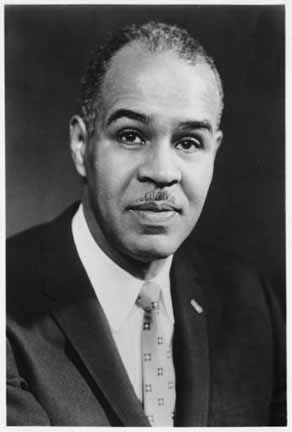
Roy Wilkins, about 1955. Image courtesy Minnesota Historical Society
50 years ago, St. Paul police tear gassed a barricaded dance hall. So began the Stem Hall race riots
By Nick Woltman | [email protected] | Pioneer Press
PUBLISHED: August 31, 2018 at 8:42 am | UPDATED: September 2, 2018 at 10:34 am
Six months pregnant in late August 1968, Teretha Glass-Kelly was feeling cooped up in her St. Paul home. So, when she heard about a dance downtown on Labor Day weekend, she wasn’t about to miss it.
“I decided I was going to go out and have a good time,” said Glass-Kelly, who will turn 70 this October. “I put a lot of work into looking cute, and not like some pregnant person.”
Local R&B groups the Exciters and the Blazers were playing that Friday at Stem Hall, which sat next to Roy Wilkins Auditorium until it was demolished to make way for the Ordway Center for the Performing Arts.
While Glass-Kelly was dancing with her sister and some friends that night, a pair of white St. Paul police officers, who were providing security for the nearly all-black event, tried to arrest a young man who flashed a pistol in a basement bathroom.
When he and his friends resisted, the confrontation escalated and the officers called for backup. During the ensuing scuffle, an officer was shot in the shoulder.
Inside the dance hall, this commotion went largely unnoticed by the revelers.
“We were in there having fun,” Glass-Kelly said. “We didn’t even know anything was wrong until the tear gas came in. You heard this thing come sliding across the floor and people screamed.”
The crying and coughing crowd of roughly 500 rushed for the exits, but they found the doors barred shut by police nightsticks.
When the young people finally got outside into the fresh air, they were confronted by a wall of officers and squad cars.
“To me, it looked like a set-up,” Glass-Kelly said. “You got out there and they’re lined up. Was this pre-planned?”
The situation soon erupted into what became known as the Stem Hall Riots. That Labor Day weekend saw 26 arrests, dozens of injuries and three more police officers wounded by gunfire. A handful of white-owned Summit-University businesses were firebombed.
The unrest shook St. Paul, which had largely avoided the widespread racial violence that elsewhere marked the late 1960s. The St. Paul Urban Coalition and the city’s Human Rights Department both commissioned studies to determine the cause of the riots.
Their investigators interviewed hundreds of witnesses and community members in the months that followed, including Glass-Kelly. They released their reports in February 1969.
“Civil disorders are the products of hundreds and hundreds of little humiliating events,” wrote Human Rights Department director Louis H. Ervin in his agency’s report.
“The tensions and frustrations of the St. Paul Negro Community have been created by so many factors and been bottled up so long that disorder seemed inevitable. Something had to give.”
‘A POWDER KEG’
The Urban Coalition and Human Rights Department probes both found that the inequality faced by black St. Paulites in education, employment and housing had for years been ignored by the city.
The 1960 census found 26 percent of black households in St. Paul living below the poverty line, compared with just 12 percent of the white households — a gap that is even wider today, according to the latest American Community Survey.
In 1968, 85 percent of St. Paul’s black residents lived in its Summit-University neighborhood, which was plagued by substandard housing and absentee landlords.
And although the city’s black population had grown by at least 35 percent since 1950, the Summit-University area had lost nearly 1,100 housing units to demolition in roughly the same period, which caused overcrowding, according to the Urban Coalition report.
The schools serving students in this neighborhood were similarly inadequate, despite two decades’ worth of St. Paul School Board studies recommending improvements, the Urban Coalition report said.
Both reports also highlighted the black community’s mistrust of the city’s overwhelmingly white police force; it employed only four black officers at the time.
The Human Rights Department had held three listening sessions on police-community relations earlier that year after receiving a series of complaints about officers’ treatment of black citizens.
After a race riot in Minneapolis the previous summer — purportedly sparked by police mistreatment of a black woman at the Aquatennial parade, according to the Minnesota Historical Society — rumors that similar violence would soon visit St. Paul circulated among its white residents, news reports said.
“It was a powder keg,” said Fred Kaphingst, a retired St. Paul police officer who was on duty the night of the dance at Stem Hall.
TWO NIGHTS OF RIOTING
Kaphingst was working the Minnesota State Fair that Friday, when his sergeant came rushing over to tell him that all sworn officers had been ordered to a riot downtown. Kaphingst picked up a helmet, riot stick and gas mask from headquarters and hurried over to Stem Hall.
When he arrived, most of the crowd had already obeyed police orders to disperse. Glass-Kelly and about 150 others remained, either because they had no way to get home or because they were angry about being tear gassed for no apparent reason.
“They’re saying, ‘Move out, move out.’ But where in the hell are you supposed to go?” Glass-Kelly said. “There were no cellphones. How do you get in touch with the person who’s supposed to pick you up?”
Some of the young people hurled bricks, bottles and insults at officers, according to the Urban League and Human Rights Department reports.
“They’re yelling and they’re throwing rocks,” Kaphingst said. “I got hit in the legs a few times — nothing serious.”
Other officers weren’t so lucky. At least one was knocked to the ground by a rock that hit him in the forehead.
When police finally pressed forward to break up the crowd by force, it split into two groups — one running east and the other running west. The officers pursued both.
Glass-Kelly was in the eastbound group, but she had to stop behind the public library because of a pain in her stomach. A police officer knocked Glass-Kelly to the ground with his nightstick, kicked her in the side and pulled her hair, she later told investigators.
“I was pregnant, but I didn’t tip the scale past 138 or 139,” Glass-Kelly said. “There’s no need to hit me or knock me down.”
Another officer helped Glass-Kelly into his squad car and drove her to the hospital, where doctors found that she was bruised but her baby was healthy.
In the westbound group, a 15-year-old boy, who told investigators he had recently undergone surgery on one of his legs, fell behind his friends on Kellogg Boulevard and was hit with a nightstick by an officer. A wound on his head required at least five stitches.
Meanwhile, the majority of the crowd worked its way up Cathedral Hill to the Summit-University area, assaulting bystanders and breaking the windows of businesses, homes and automobiles along the way, the reports said.
Kaphingst and his fellow officers cordoned off much of Selby Avenue and spent the next several hours racing from call to call.
Ed Steenberg, another retired St. Paul police officer, was at home sick with a 102-degree fever that night, but he was also summoned to the riot because he walked a foot patrol on Selby. His superiors hoped he could leverage his connections in the community to calm the rioters.
“I knew everybody,” Steenberg said. “When you’re walking a beat, you get to know the people under a whole different set of circumstances.”
Steenberg helped gather some clergy and community leaders who asked the young people to go home, but to no avail. Things didn’t quiet down until about 4 a.m.
The next night, Kaphingst was back at his post at the State Fair when his sergeant again raced over to relieve him, saying that buildings were burning in Summit-University.
Molotov cocktails had ignited three neighborhood businesses shortly after 9 p.m., and the firefighters sent to extinguish the blazes were being shot at. Officers searching for their assailants were hit by shotgun pellets.
Two pairs of white men with shotguns were arrested in the area that night but neither was charged with the shootings, according to newspaper reports.
Kaphingst and Steenberg again worked through the night, but Saturday was comparatively quiet.
“It petered out early in the evening,” Steenberg said. “Their numbers were so much smaller that it wasn’t so much an issue from then on.”
AFTERMATH
In the weeks after the riots, the Human Rights Department and the Urban Coalition undertook their independent investigations of the violence. While Ervin led his department’s efforts, the Urban Coalition recruited then-Macalester College President Arthur Flemming, who would go on to serve as chairman of the U.S. Commission on Civil Rights under four presidential administrations.
Both groups faulted the police for tossing tear gas into a locked dance hall full of innocent people.
“The gas affected the crowd indiscriminately,” the Urban Coalition report said. “It is clear that from the time the gas was thrown into the hall, a wider disturbance was beyond prevention.”
But they also credited the police for their restraint during the subsequent riots.
The Human Rights Department said it was “critical of some ineptitude, even misconduct, on the part of members of the police and of the level of their training in general. While this can be said, it ought not to, and will not, detract from the exemplary conduct of many assembled officers, who maintained discipline under pressure and who endured gunfire and danger without similar response.”
The reports praised members of the city’s black community, too, for working to contain the violence that weekend.
“It could’ve been worse,” Steenberg said. “I would say that both sides tried to keep it down.”
Glass-Kelly, who delivered a healthy baby boy three months after the riots, has tried to put the events of that weekend behind her, not even telling her kids about it in detail.
“It’s not anything that I talked about,” she said. “You don’t want to say, ‘Yeah, these cops did that to me,’ and ingrain this kind of thing in them about police officers.”
Growing up in the Rondo neighborhood in the 1950s, she remembers only positive encounters with police — especially a beat cop who was beloved by neighborhood kids.
He had a gun, he had a uniform, but nobody feared him,” she remembered.
But her experience at Stem Hall forever changed the way she viewed law enforcement.
“That incident was my first real eye-opening to what police could actually do to people,” Glass-Kelly said. “I do not believe — and there’s no way anybody can ever convince me — that every cop is a bad cop. But I know that there are some bad cops.”
The St. Paul Hotel (Hotel St. Paul) is located at 350 N. Market Street. It was built in 1910 and still exists today.
Known as “St. Paul’s Million-Dollar Hotel,” the building opened on April 18, 1910, with guests such as James J. Hill, businessman and early 3M investor Lucius P. Ordway, and John Ireland, archbishop of St. Paul.
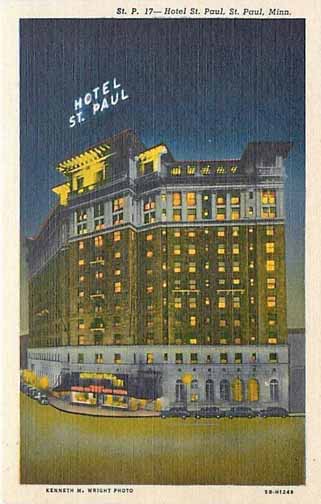
Hotel St. Paul, 1915. Courtesy Minnesota Historical Society
In 1928 KSTP Radio began broadcasting live from the Gopher Grill. I the 1930s the show was called “Dancing in the Twin Cities.” These broadcasts lasted until the 1950s.
The hotel underwent extensive renovations in 1935.
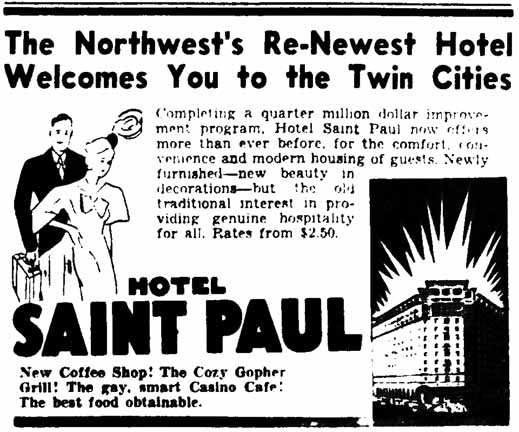
November 10, 1935, Des Moines Register. Image courtesy Joe Haupt
In 1937 a young Lawrence Welk began playing in the hotel on Saturday nights.
In December 1938 the hotel engaged the black swing band El Herbert for a three-week stint, reported as “the first engagement of a colored band in any of the larger hotels in the Twin Cities in recent years” by the Minneapolis Spokesman.
In the 1950s and ’60s, the Dixieland music of Harry Blons was featured in the Gopher Grill.
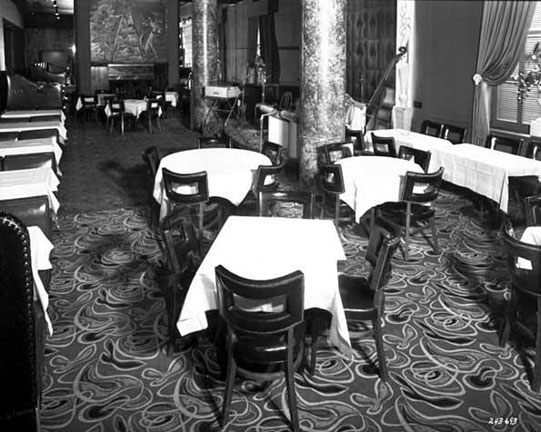
Gopher Grill, 1957, courtesy Minnesota Historical Society
In 1963 the Gopher Grill and Bar Restaurant had nightly dancing and entertainment.
In 1979 the owners decided to give the hotel a facelift and sold off everything, from tables, chairs, televisions, mirrors, china, silverware and carpet. By 1982 the 254-room hotel had been redesigned and restored.
The St. Paul House in Shakopee (“since 1854”) was owned by Ben Klayman in the mid-1950s. The February 1960 Select called it “The New” St. Paul House, and presented the St. Paul House Singing Sextette with colorful presentation of Broadway hits. Members were Bruce Neilson, Ronelle Sinjem, Jane Sorber, Bill Lutz, Ann Thorgrimson, and Russ Miller. Another note said that the venue featured Irv Trestman’s Lamplighters in 1960. 1963: Piano bar in Mardi Gras Room, Dancing.
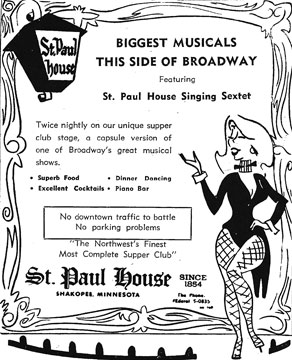
Ad from June 1963 Twin Citian
The Stables was a night club located at 316-320 7th Ave No. in Minneapolis. The permit card says that a previous dwelling was demolished in 1915. The next building was erected in 1925, and was variously a warehouse, a schoolroom, an office, and a garage. The building still stands, renumbered as 615 3rd Street N.
The Stables opened in early December 1927. It got its name because it was located in a former horse stable. The house band was Red Clark’s Jockey Orchestra. It was open every night but Monday and on Sunday afternoons.
Owners were Werner H. “Vern” Ruff, a grocer, and John H. Woodward.
Ruff was accused of giving Woodward $1,000 to give to one or more aldermen in order to facilitate the granting of the dance hall permit. They were served with subpoenas to answer questions, and when they refused to satisfy the inquiries, they were both sentenced to jail terms.
It was raided by the Federal authorities on March 11, 1927, and Federal Marshals padlocked it for one year on July 20, 1928.
More to come
Highway 8, 3 miles north of Highway 10 in the Northway Shopping Center in Lexington Village. 1968 attraction was Jack Greene, plus Les Cunningham and the Stage Hands. “Largest Country Western Music Palace in the Nation!”
This page discusses the following venues at the same location:
- The Stagecoach
- Twins Stagecoach Inn
- 1 & 44 Club
- Barbary Coast
- Doc Holliday’s
THE STAGECOACH
The Stagecoach started out as an actual stagecoach stop called the Four Mile House between Shakopee and Savage in the horse and wagon days.
In about 1951, Osborne “Ozzie” and Marie Klavestad found the old place by accident and bought it for a place to display Ozzie’s gun collection. They named it the Stagecoach Museum, and over the years it expanded to include the Stagecoach Restaurant, Stagecoach Opera House and the Sand Burr Gulch, a recreated old west street complete with blacksmith, barber shop, saloon, and animated cowboy puppets that acted out jerky wild west scenes for the general public.
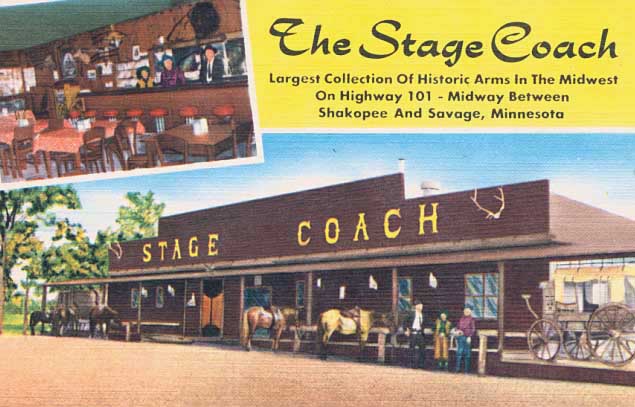
1970 image courtesy Minnesota Historical Society
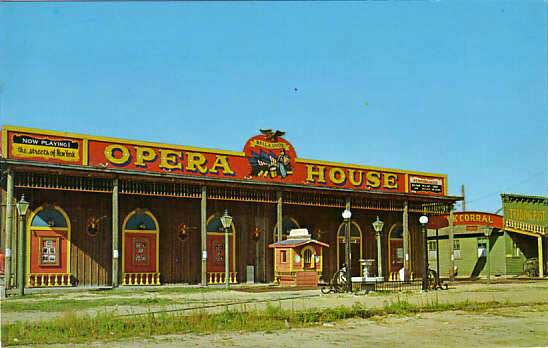
TWINS STAGECOACH INN
In May 1970, the Stagecoach Inn opened – Will Jones characterized it as “an entirely new and separate establishment, a vast two-story frontier-type dining hall and saloon. Klavestad had held a liquor license but never used it until Ray Colihan and his partners, twins Billy and Jimmy Robertson of the Minnesota Twins, bought the food and beverage concession and the right to the Stagecoach name. It was officially called the Twins Stagecoach Inn to distinguish it from the museum and theater. The balcony, called “Reggie’s Roost,” could hold 400 people, and had a 65-foot bar that Colihan called the longest in Scott County.
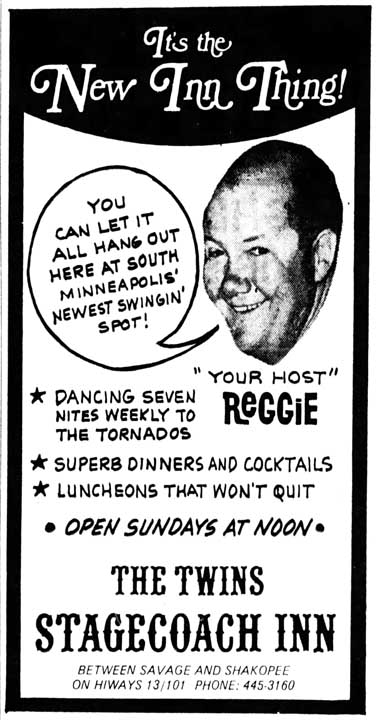
Star Tribune, July 12, 1970
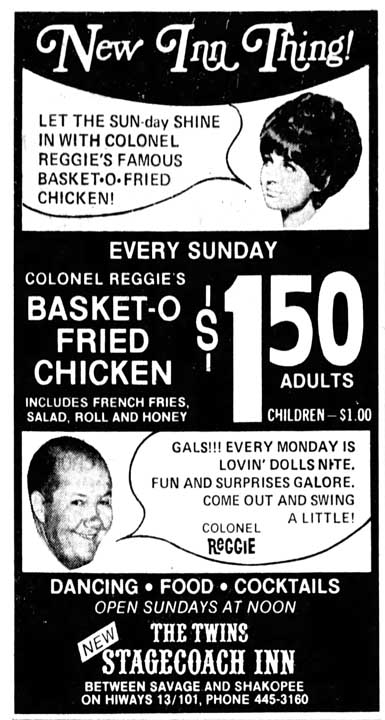
Star Tribune July 19, 1970
1 & 44 CLUB
The 1 & 44 Club was up and running by about May 1972. I would love to know the origin of the name!
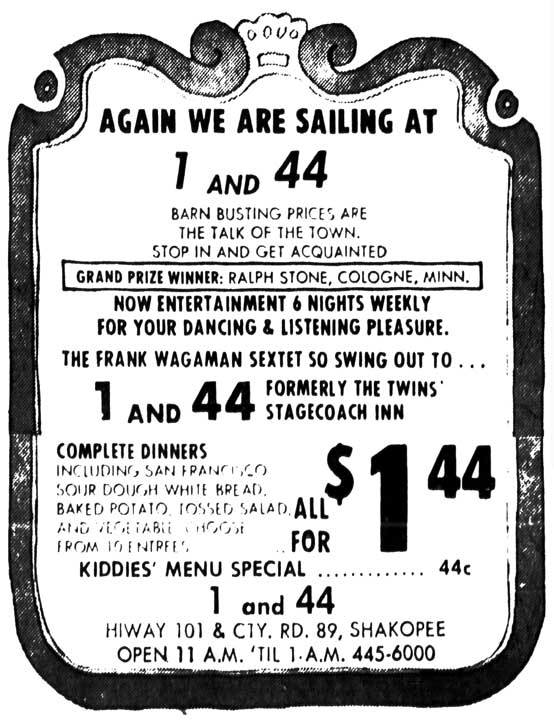
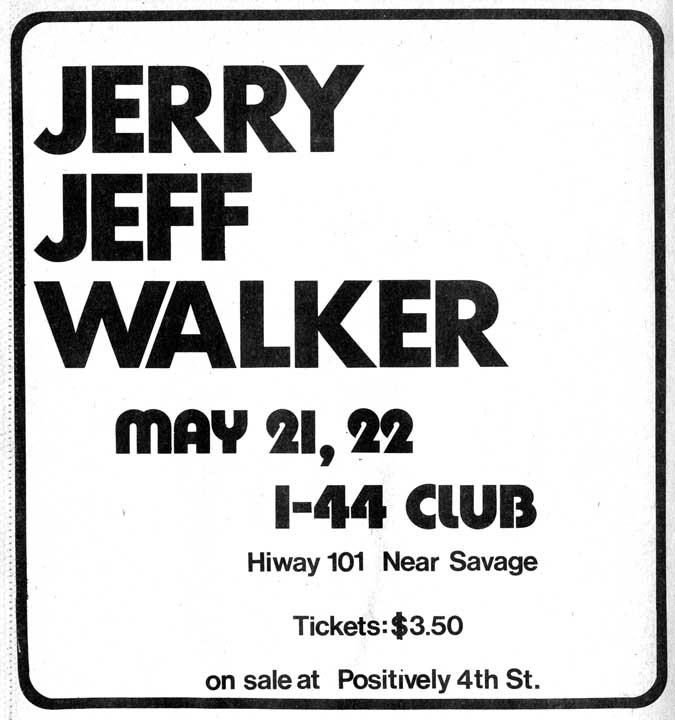
1973
The 1 and 44 was still there in September 1974. It was mostly a Country/Country rock place, although Chubby Checker did a two-night stand there.
BARBARY COAST
This short-lived club followed the 1 and 44, starting in about September 1975. Apparently the Barbary Coast in general was a hot topic – a major TV movie, a series or mini-series, and a Barbary Coast Jazz Band making the rounds.
But mostly there was Wayne Cochran, as a reader named Len hipped me too. He sent me this great poster:
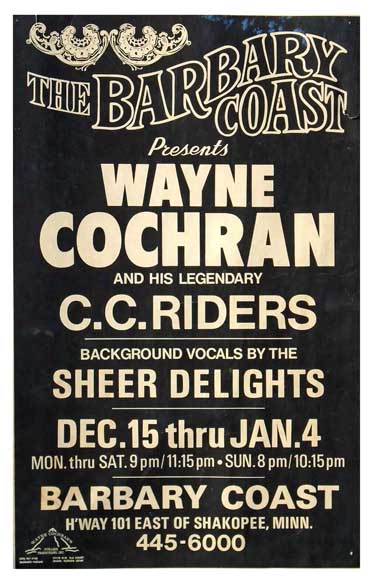
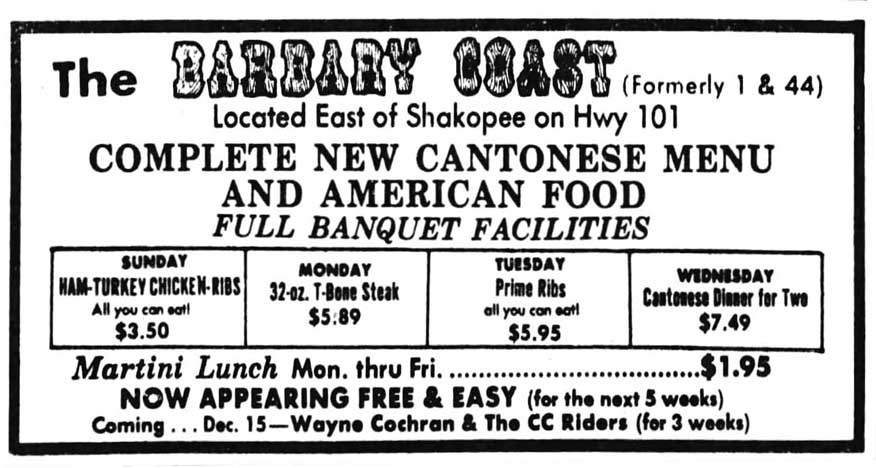
Minneapolis Tribune, November 2, 1975
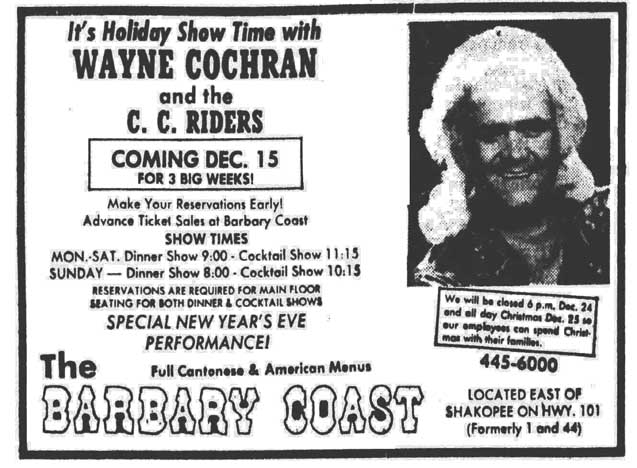
Minneapolis Tribune, December 7, 1975
DOC HOLLIDAY’S
Doc Holliday’s appeared in about June 1976.
Jon Bream described it as a “two-story, ski-lodge-like bar.”
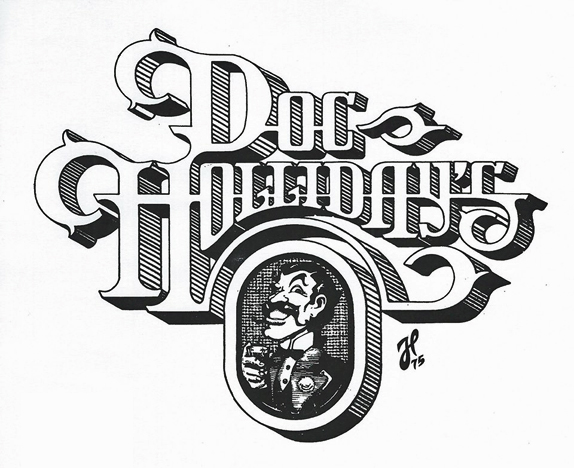
Logo by Logo King Johnny Hanson
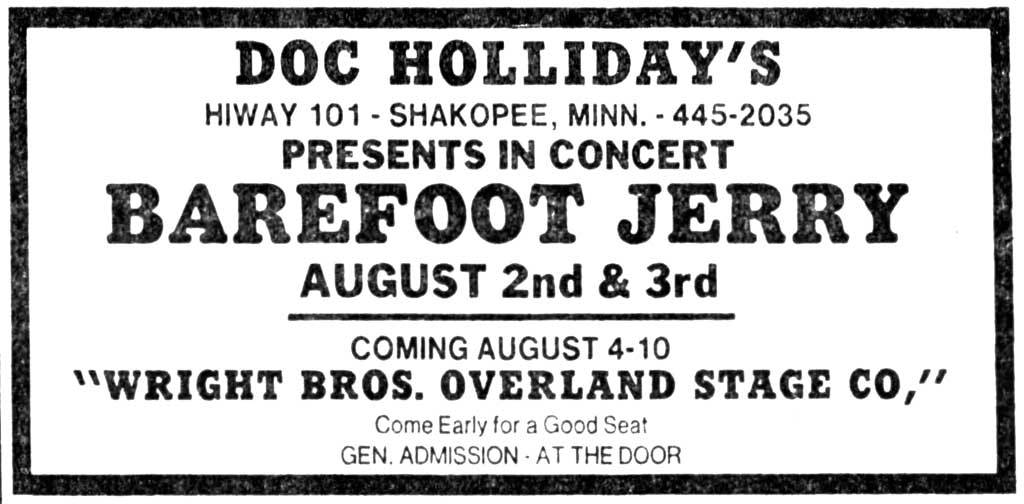
1976
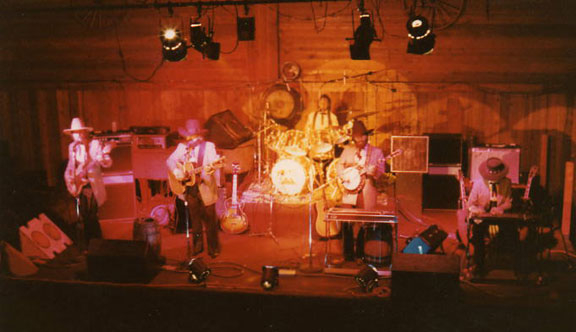
Wright Brothers Band, July 1977, at Doc Holiday’s. Photo by Craig Mickelson, Spearfish, South Dakota
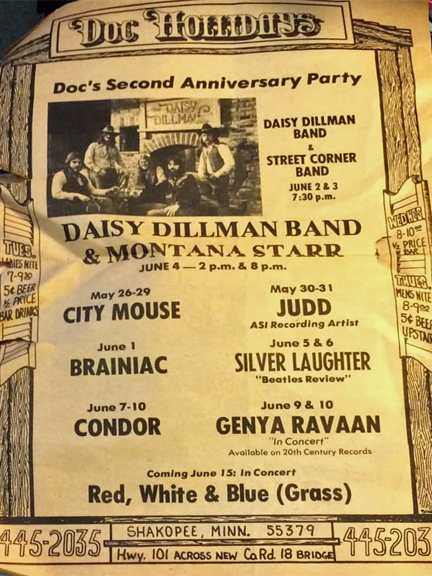
1978 Flier courtesy Sandra Kenyon
Some of the national acts that appeared at Doc Holliday’s included:
- Dr. Hook, with Willie and the Bumblebees, November 16 and 17, 1976
- Larry Raspberry and the High Steppers, October 14, 1977 and October 27-29, 1977
- Larry Gatlin, December 9, 1977
- Canned Heat, June 20, 1978
- Asleep at the Wheel, June 29, 1978
- Jimmy Witherspoon, August 11-12, 1978
- Johnny Paycheck, January 20, 1979
- Billie Jo Spears, January 26, 1979
- Bellamy Brothers, March 30, 1979
- Asleep at the Wheel, May 15, 1979
MURDER AT DOC HOLLIDAY’S
Tragedy struck on May 5, 1979, when Barbara Smith was fatally shot at the club. In 2021, Barbara’s friend Paul Eggert, wrote to say that he was going to go with her that night but he could not get off of work. Barbara went with her brother Tom instead. Barbara was a 1975 grad of Harding High School – her birth date was November 23, 1957, and she was one of eight children. Paul wrote, “She was in my opinion, stunning. I don’t want her to be just a footnote and forgotten.” Barbara’s niece Rachel Grove contributed additions and corrections to this account on Facebook.
According to memories on Facebook, Daisy Dillman had just finished “Southern Man” and was taking a break. Larry Lyle Marquardt of Minneapolis and David Kraml of Bloomington had been thrown out for being drunk, and came back with a .308 caliber hunting rifle. Marquardt shot two rounds into the second floor of the building. Barbara was wounded on her ankle, and when she leaned over to look, and was shot again in the neck. Another male customer was seriously wounded as well. The club held 800 people and was packed. “A group of bikers had the shooter on the ground and were kicking the shit out of him, says one witness. “Then the law started to defend on the place. I had never seen so many state troopers and county sheriffs cars in my life.”
Marquardt plead guilty and was sentenced to eight years in Stillwater. The club reopened on May 14, 1979, but the City Council was on its case for fire code violations including overcrowding.
THE END OF THE STAGECOACH
A fire on June 21, 1979, was the last straw, doing $10,000 in damage. Although Montana Star was scheduled to play on June 22-23, 1979, it appears that the last band to play at Doc Holliday’s was, in a macabrely appropriate way, called Headstone. The owners withdrew their application to renew their liquor license and it expired on June 30, 1979.
An ad appeared on November 7, 1979, soliciting someone to lease the 17,000 sq. ft. property.
The Klavestads sold out in 1981 and the place fell into ruin. Widening of Highway 101 spelled doom for the site and most of it was demolished in 1996. Sandra Kenyon thinks the Doc Holliday’s site is gone, but the original Stagecoach building still stands as Dahlen Signs, 901 Stagecoach Road, Shakopee.
STANDARD THEATER
In the 1870s, the variety show – forerunner of vaudeville – emerged in the theaters of Washington Avenue. According to a 1928 paper by Randolph Edgar, the first theater to play variety was the Standard, which was built in 1878 at 124 Washington Ave. North. It was managed by the “notorious” Captain W.W. Brown, and lasted for only three years, closing in 1881.
The second Standard Theater was located at 210 South Third Street in 1887. Randolph Edgar wrote that it only lasted one year, because the “Variety Show” form of entertainment – a precursor to vaudeville – had gone out of style
The State Theater is located at 805 Hennepin Ave. in Downtown Minneapolis.
From the Hennepin Theatre Trust, which owns the theater:
The State Theatre, which seats 2,181, opened in 1921 and was then considered the most technologically advanced and elaborate theatre in the United States. One Minneapolis newspaper columnist described it as “a gilded pleasure palace, dedicated to the Hollywood dreams that captured America’s heart in the roaring ’20s.” It was designed by Chicago architect J.E.O. Pridmore in a free Italian Renaissance style and boasted the first well-driven air conditioning system in Minneapolis. The original stage floor was glass, lit from underneath to create stunning visual effects.
The opening night program included a silent film, newsreel and travelogue. A Wurlitzer pipe organ was installed in 1925 and concerts were held every day for 25 cents. The State’s neon marquee was installed in the ’40s and runs the entire width of the theatre. Between 1921 and 1978, the State Theatre was used primarily as a movie house, but also hosted vaudeville acts including Nora Bayes and Victor Herbert, concerts and ballet. The movie screen was the largest screen west of the Mississippi River at the time and designed so every person had a perfect view of the film.
Photos below from 1938 and 1940, respectively, courtesy Minnesota Historical Society
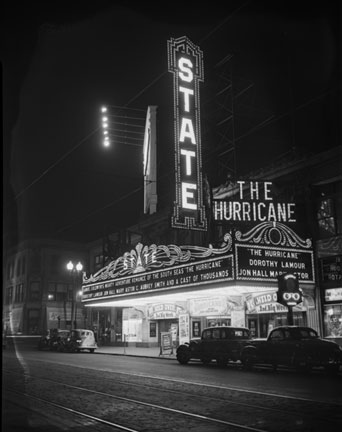
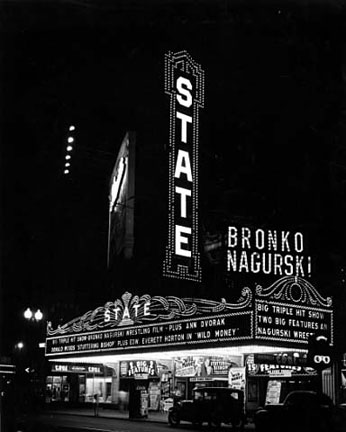
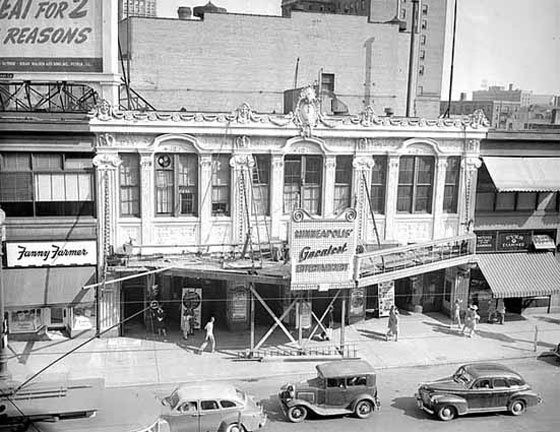
In 1942 the front of the theater was remodeled; photo courtesy MHS
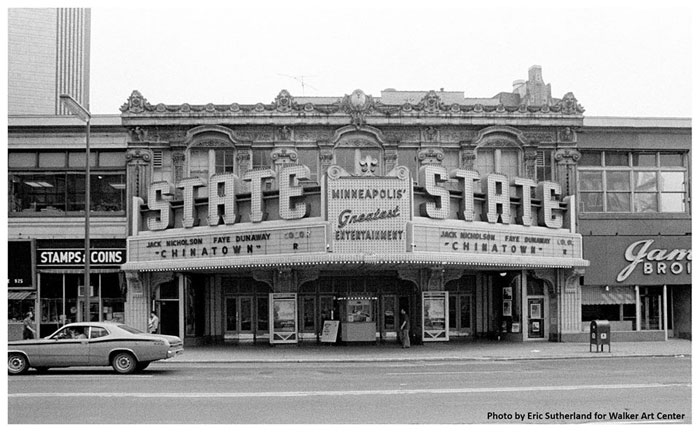
Photo by Eric Sutherland for the Walker Art Center
The 1974 photo above was taken by Walker Art Center staff photographer Eric Sutherland, for possible inclusion in the Walker’s 1974 publication Design Quarterly # 93: Film Spaces. The image was not published. Courtesy Walker Art Center and Barb Economon.
“Butch Cassidy and the Sundance Kid” set a national record at the State in 1970 for the longest run in America (34 weeks). The final picture show was “Tommy” on New Year’s Eve 1975. In 1978, the theatre was purchased by the Jesus People Church and served as their place of worship. The church covered the murals and sculpted figures with drapes and plaster shields, which were removed during the renovation process.
The Minneapolis Community Development Agency purchased the LaSalle Plaza block in 1989, including the State, as part of the LaSalle Plaza development. After nearly two years of renovation at a cost of $8.8 million, the State Theatre re-opened in November of 1991 with the Minnesota Opera’s production of Carousel. The restored proscenium spans almost the full width of the building and curves 100 feet above the stage. The six chandeliers in the house are original, as are the murals on the walls. Since the re-opening in 1991, the State has hosted live Broadway touring productions such as Avenue Q, Sweeney Todd and Joseph and the Amazing Technicolor Dreamcoat, concerts featuring Patti Smith and Gordon Lightfoot, author and adventure speaker series and films including the world premiere of the Minnesota-based movie, “Grumpy Old Men.” Hennepin Theatre Trust is now the owner and operator of this magnificent structure.
Steak and Ale was a meat (and seafood) and potatoes restaurant located at 2801 Southtown Drive in Bloomington. There were two other restaurants in St. Louis Park and Roseville.
The company was a chain out of Dallas that started in 1966 by an entrepreneur named Norman Brinker. By 1975, ads for help at the Bloomington site were being published. The chain of 111 restaurants in the U.S. and Canada was acquired by Pillsbury in 1976 for $100 million in Pillsbury stock. Brinker was kept on as Steak and Ale Chairman, and would later become an executive at Pillsbury, starting Bennigan’s, Jack-in-the-Box, and Chili’s.
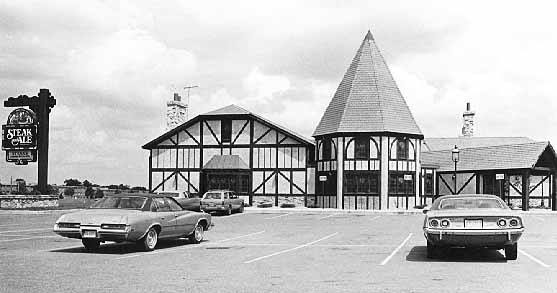
1976 photo courtesy Minnesota Historical Society
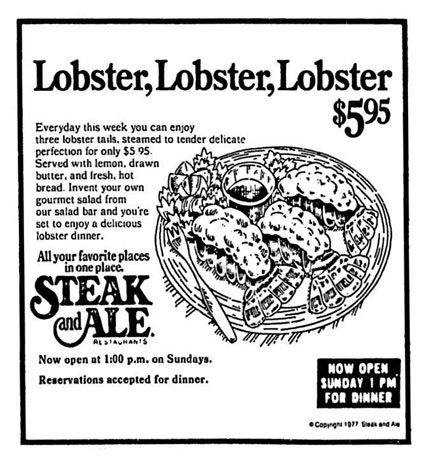
1977 ad courtesy Dale Westdal
A food review from 1977 wasn’t too kind to the restaurant’s decor, saying “It is best to ignore the pretentious architecture, the fact that the menu is printed on an imitation meat cleaver and the phony fires that are crackling in the fireplace… I understand the chain’s 100-plus restaurants are constructed in the same English-manor-house-cum-castle style with a phony turret on one side. It is a tribute to the determination of Americans to eat in restaurants built to look like something else.” The review dinged the place for chilling the Bass ale, as everyone knows, such is served at room temperature in Jolly Old England. But he approved of the miniskirts on the waitresses. As for the food, skip the steak and just go for the crab legs. (Joe Blade, Minneapolis Star, January 5, 1977)
Scott Smith loaned me this “menu” to photograph, and it really was metal and it really did weigh a ton!
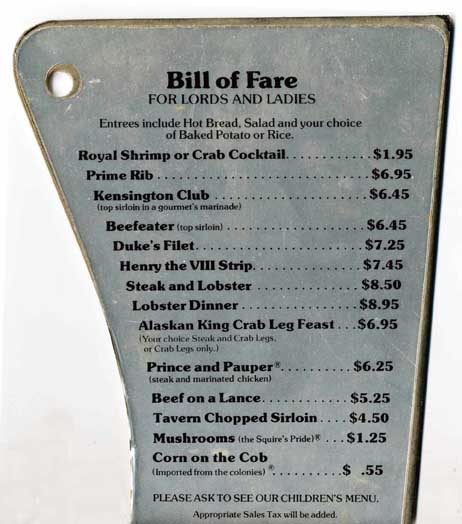
Cleaver menu image courtesy Scott Smith
Here’s a singing commercial from 1978 that our friend Jeff Lonto found that gives the spirit of the place!
MUSIC AT THE STEAK & ALE
A blurb in 1977 says that there was live music and dancing in the lounge (apart from the restaurant) from 8:30 to 12:45, with drinks from $1.35 to $1.80.
The first listing found in a Minneapolis Tribune entertainment calendar was on November 25, 1977, with a band called Twighlite Central. That doesn’t mean there wasn’t entertainment before that, of course.
The mid 1980s featured bands such as Water and Wine, the Core with Patty Peterson and Steve Faison, and the Wallstreet Band. The ’90s brought Solution, the River Rats, Full Moon, the Whirlies, HeadFirst, and Bourbon Street, to name a few.
Drummer extraordinaire Bobby Vandell remembers:
Steak and Ale had a run as a very active live music venue. We had a band called Everyday People/Harlow that worked there five nights a week and packed the place. We had people standing in the aisles to see our Wiz show that Corliss Dale Forestieri choreographed, and sang so great in, Howard Arthur played guitar in and was music director. Stephen Faison and I shared the Lion character duties! It was a killer show that was very popular. We took it to Los Angeles for about a three month run at the Bonaventure Hotel in downtown LA. Other bands worked there as well … Class Action was an all- star band that included Ricky Peterson, Patty Peterson, Stephen Faison, Candy Robles (Candy Anderson then), Rick Houle, Rick Cornish, and Glenn Swanson. They were killin’ and packed the place too! The Steak and Ale, with its tiered seating, made a perfect live music venue … And that it did! Great memories from those days.
Patty Peterson remembers also how her bands “packed houses six nights a week and people lined up out the door to get in.”
Below are some photos of the Doug Maynard Band from about 1981 taken at the Steak and Ale.
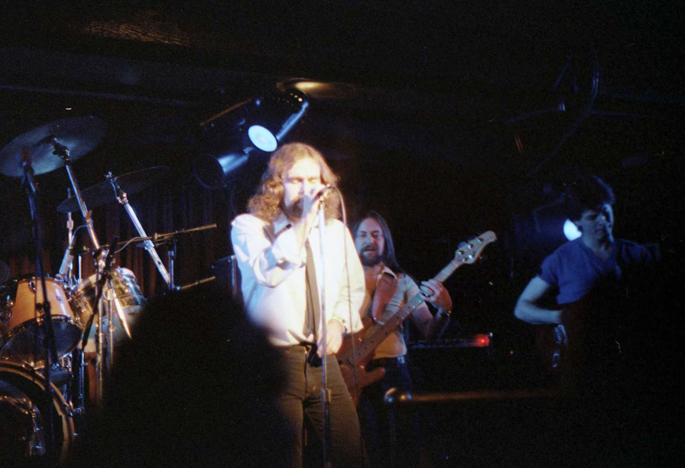
Doug Maynard – photo courtesy Doug Sougstad
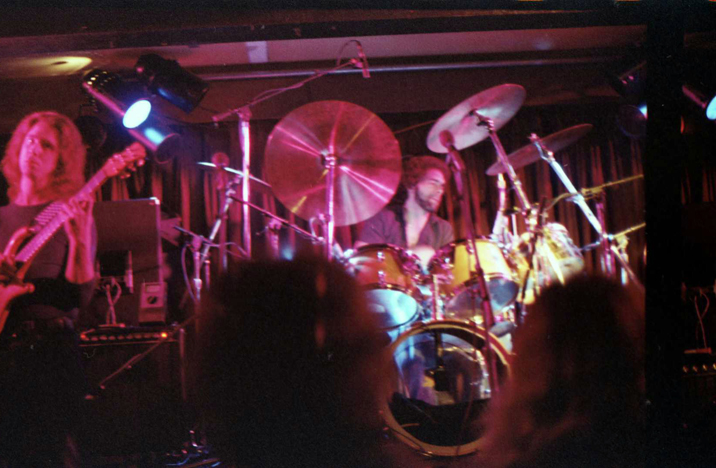
Bobby Vandell – photo courtesy Doug Sougstad
Erik on Facebook remembers great memories working there in the late ’80s early ’90s, working busy Saturday nights while Patty Peterson and her band played in the bar doing great Anita Baker covers.
Singer Connie Olson remembers singing there many times.
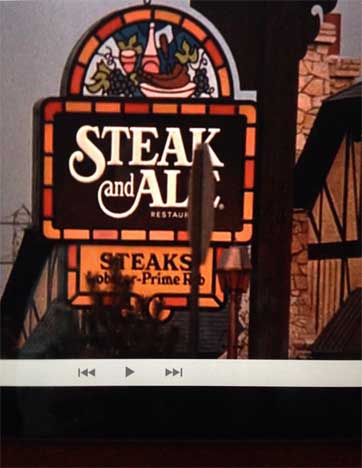
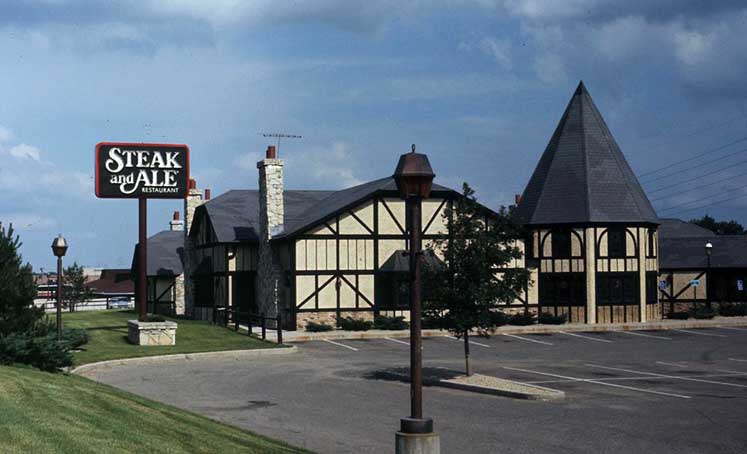
Photo courtesy Joel L. Johnson
ABBA AT THE STEAK AND ALE
In 2006, ABBA’s Benny Andersson was in town and had hired local Swedish-born student Martin Bertilsson to drive them around and show them the sights. Martin tells his story on YouTube about the night he recommended the Steak and Ale to one of the world’s biggest pop stars! (Thanks to Luke Taylor for the tip!)
Steak and Ale closed in about 2008.
COWBOY JACK’S
The building went on to become Cowboy Jack’s Bar and Restaurant: “Raucous hangout features booze, casual grub & regular live bands in a rustic Western-themed space.”
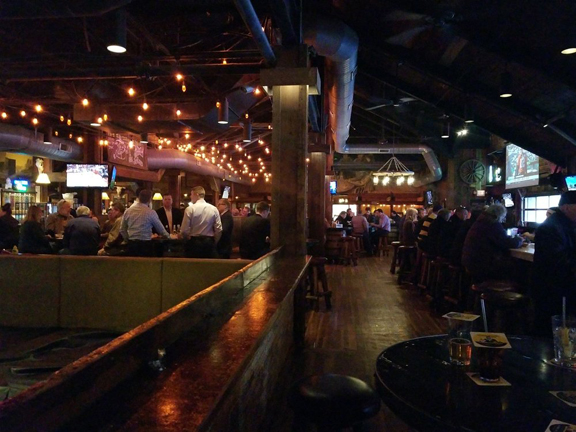
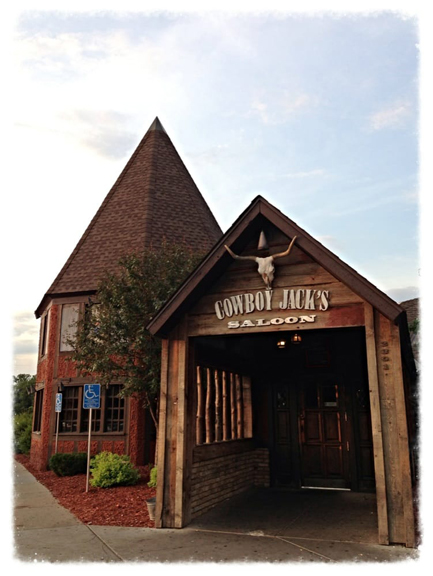
Stefano’s was located at 316 Cedar Ave., which is now a part of 320-322 Cedar.
The first we see of Stefano’s in a search of the Strib is an art exhibit on June 29, 1957.
In July Will Jones made note of the Stefano Players, “veteran University theater performers,” who read plays at the pizzeria.
Jones mentioned Stefano’s often; in October 1957, calling it a pizzeria with its own printing press and theater group. He quoted pithy sayings from the establishment’s newsletter by Tony Mastrey, Rod O’Donnell, and Tom Malthus.
An August 1959 rundown of dining venues published by Jones in the Minneapolis Sunday Tribune describes Stefano’s as the “original home of Minneapolis’ would-beatniks. Assorted jazz Friday and Saturday nights. Art exhibits. pizza, spaghetti. Open 5 pm to 3 am.
Western and Como Ave., St. Paul. Site of AKA’s “Apache Dance” on May 24, 1935.
315 North Dale Street at Rondo, St. Paul. Founded in 1918, incorporated in 1919 as a private club for Black professional me to meet and network when they were not allowed in white facilities. Site of dances in 1937. In 1958 it built a new home at 300 North St. Albans at Carroll. Photo below taken in 1926 – Minnesota Historical Society.
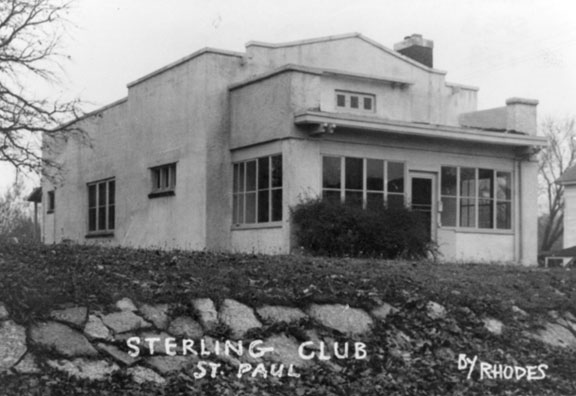
The Little Sandy Review reported on a series of shows by Grandpa Jones and his wife Ramona at this “juke-joint dance hall.” Circa August 1961.
The Stockholm Bar had at least two locations.
31-33 WASHINGTON AVE. SO.
Permit card information starts in 1888, but the building must be older than that if the bar goes back to 1883. During the 1920s, the building housed a billiard hall.
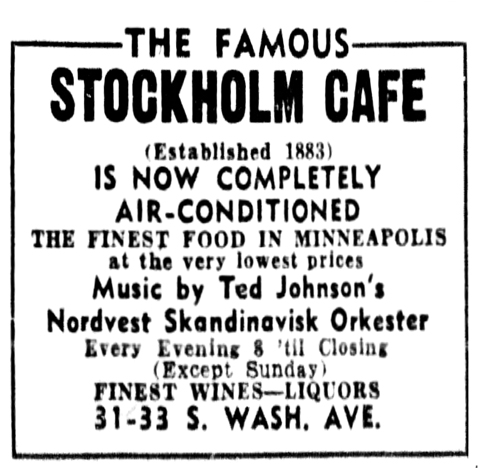
Minneapolis Tribune, July 12, 1937
An article in the Tribune on July 31, 1977, said that the Stockholm had been “known nationwide as a fine Scandinavian restaurant.”
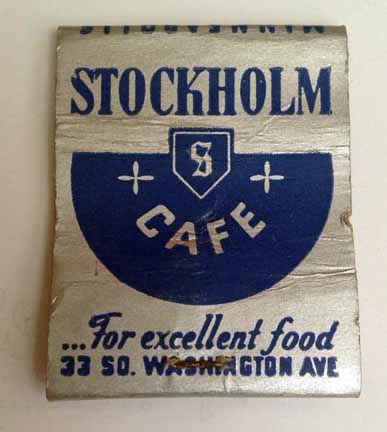
From the collection of Mark Youngblood
The ad below gives us the date 1882 as the origin of the bar, and says that Slim Jim, a singing cowboy, was the entertainment in 1945.
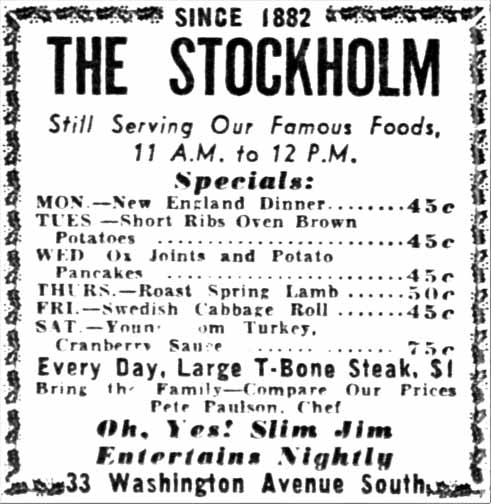
Minneapolis Tribune, December 23, 1945
In 1949 the liquor license was held by Elmer N. Nelson and Leonilla L. Berman. In December 1949 the license was transferred to Albert Osman.
The photo below from 1953 shows Skid Row residents congregating in front of a sign that advertises Good Food and Dancing. The place must have been larger than the average Skid Row bar to be able to accommodate dancing. Also, in order to even allow dancing, a proprietor had to have a specific license. It wasn’t like the movies where a kid could go to a drug store, put a nickel in a juke box, and whale away. Such were the rules of Minneapolis.
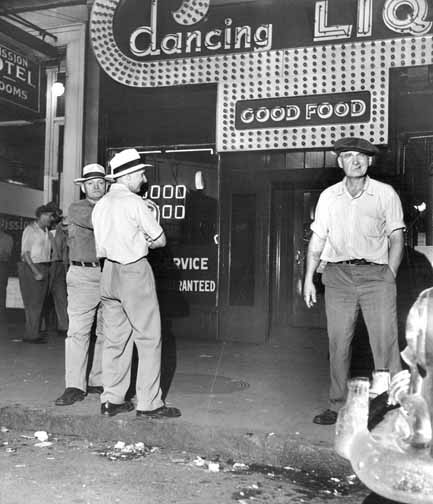
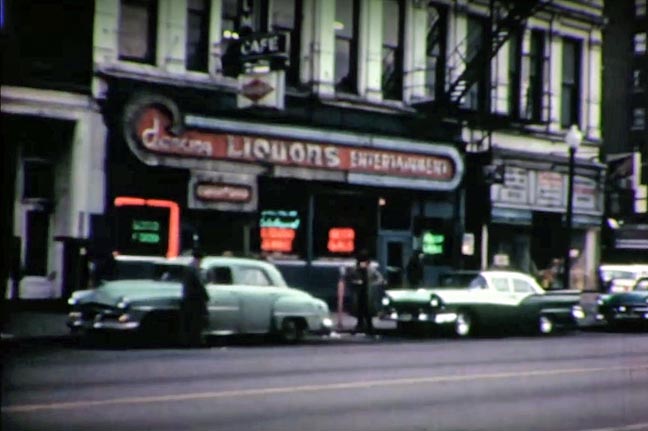
This is an image of the Stockholm from John Basich’s film of Skid Row.
In 1959 the owner was named as Mitchell Osman, Albert Osman’s brother, who planned to move the Stockholm to a building at Third Street and Third Ave. in preparation for the clearing of the Gateway.
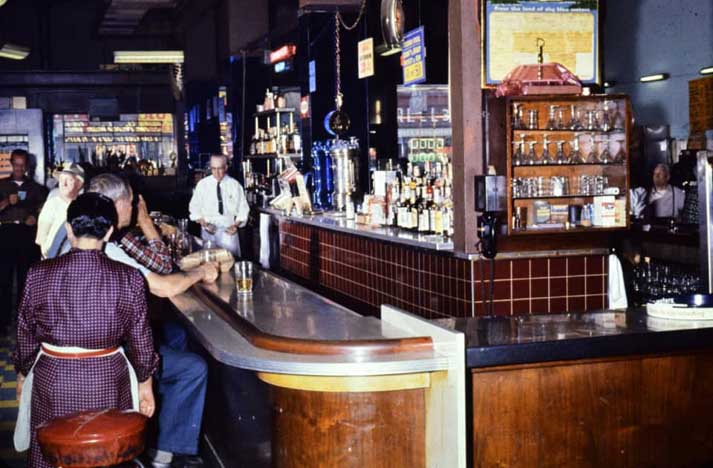
1960 photo courtesy Hennepin County Library
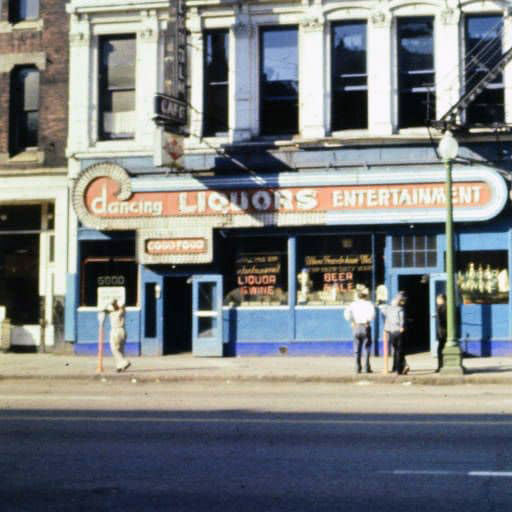
@ 1961 Photo courtesy Hennepin County Library
The building at 31-33 Washington Ave. So. was demolished in about February 1962.
300 SO. THIRD STREET
By August 1962 the bar had been moved to its new location at 300 So. Third Street in Minneapolis. Don Morrison was not impressed, calling it “That typical, bland, impersonal, nameless walnut plywood style of decor that I think of as Dentist Waiting Room Swedish.”
In March 1967 the bar featured the Phil Rito Trio.
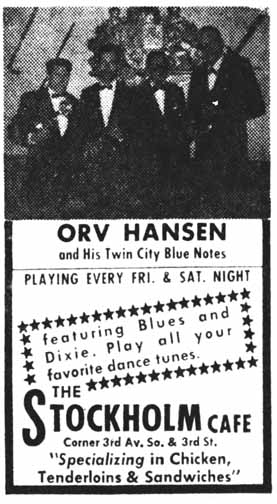
Minneapolis Star, October 6, 1967
Incongruously, in 1974 the Stockholm served Chinese food. The ad below dates the establishment back to 1880.
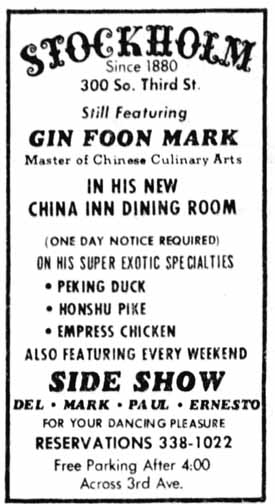
Minneapolis Star, April 12, 1974
The Stockholm Bar lasted until at least 1978.
Stransky’s Recreation was located at 1209 West 7th Street in St. Paul. This page will cover all of its entertainment iterations, including:
- Trabert’s Place
- Stransky’s Bar/Rec
- Highland Rec/West Seventh Street Rec
- Cooper’s West
TRABERT’S PLACE
The building was originally Trabert’s Place. Bob Furnow provided me with an article that Jim Landsberger published about the history of the place in the West 7th Street Reporter. Landsberger wrote:
Frank J. Trabert was born in 1860 in Holstein, Germany. He immigrated in 1884 with his wife, Minnie. He opened his saloon in 1903 with his son Theodore as bartender, and he had a boarder, Carl Seifert as “porter.” After her husband died, Minnie continued to take in borders at 641 Lee Avenue. Her son became a hotel clerk in 1920 [The saloon had succumbed to Prohibition.]
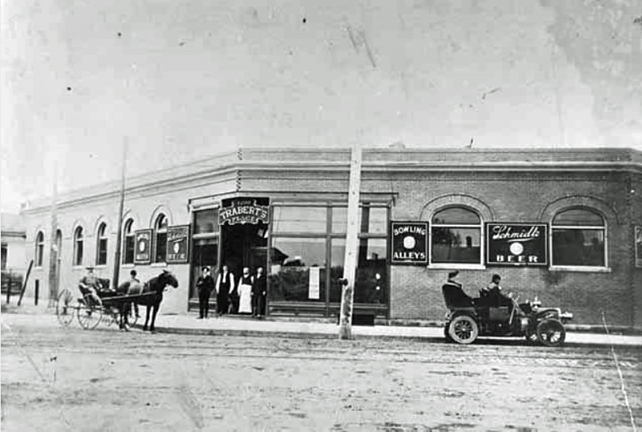
1909 Photo courtesy Minnesota Historical Society
STRANSKY’S RECREATION
Landsberger:
Next to acquire the saloon was Louis Stransky in 1933 (the end of Prohibition), and he eventually changed the name to Stransky’s Recreation. Louis Stransky emigrated from Bohemia in 1883 with his parents. His wife, Lillie, was born in Minnesota to Bohemian parents.
A Joseph Stransky, Jr. appears in print in February 1936.
The building held an 8-lane bowling alley as well as a night club.
In 1940 the Al Kolech Orchestra provided musical entertainment.
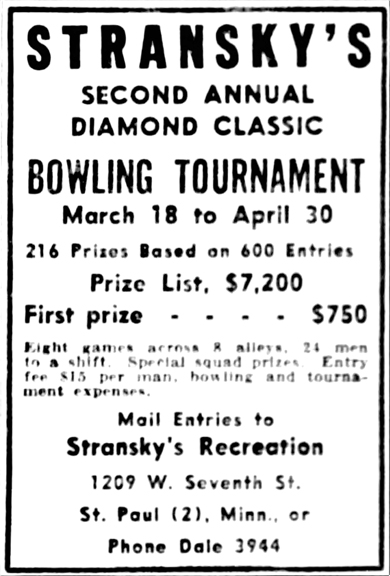
Strib, March 12, 1944
In April 1944 there was a reference to Joseph Stransky’s Tavern, where a woman from Kansas City got mixed up with a military deserter only to get her purse stolen.
In March 1945, Joe Stransky Jr. and his bartender were each fined $100 for selling liquor on a Sunday. Called a “flagrant violator who has never paid attention to laws and regulation,” Stransky had his bar license revoked the following month. He reapplied for the license, but over 300 members of the Fairmount Ave. Methodist Church signed a petition objecting to the action. Stransky had really cheesed off the clergy, as the Methodist Ministers Association of St. Paul and the St. Paul Ministers’ Association also registered their opposition to reissuing the permit. Despite these protests, the council (with the Mayor breaking a tie) voted to reinstate the liquor and restaurant license after a 30-day suspension, as per protocol.
According to Landsberger, Al Danneker opened a cafe in the building in 1947.
In 1948 there was the After Dark Room, with music by Jack White.
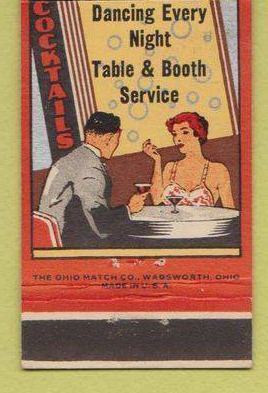
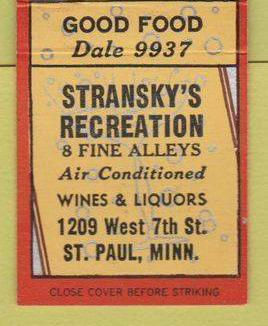
In 1950, Augie Garcia was a regular at Stransky’s, as indicated by these photos from the Minnesota Historical Society.
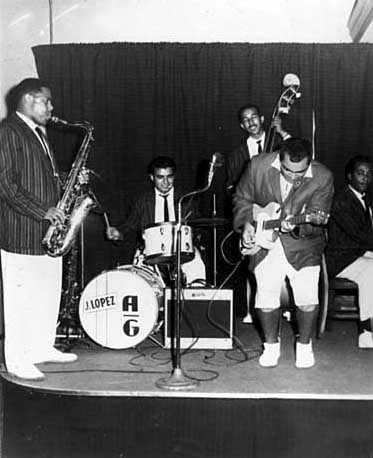
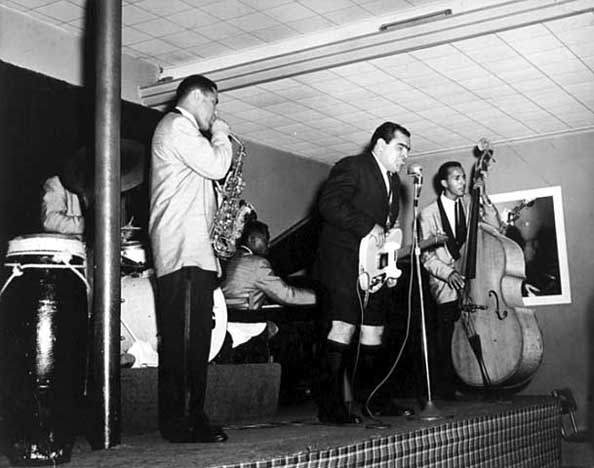
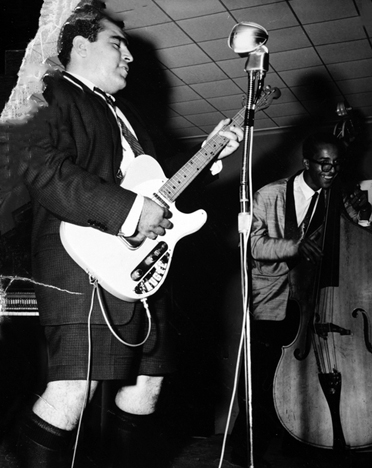
In April 1951, Ginny Sims appeared in the After Dark Room with Jack White’s band.
WEST SEVENTH STREET REC/HIGHLAND REC
In July 1951 Joe Stransky apparently sold the property to Clayt Brenner. Brenner expanded the bowling area and eliminated the tavern, according to the St. Paul Musician magazine. The property was renamed West Seventh Street Rec., also known as Highland Rec. Bob Furnow says: “I don’t know why they called it the Highland Rec because Highland Park is about mile or two down 7th, but a lot people still called it Stransky’s & Highland Rec for years after. I remember people still calling it that way after it wasn’t those names anymore.”
In November 1953, jazzman Harry Blons appeared with vocalist Joann Dale. The show was hosted by Bill Larson, Jr.
Later, Highland Rec became a home base for Augie Garcia, the Godfather of Twin Cities Rock ‘n’ Roll. St. Paul Musician magazine cites him there in June 1955, November 1956 (on Tuesday nights), and in 1958.
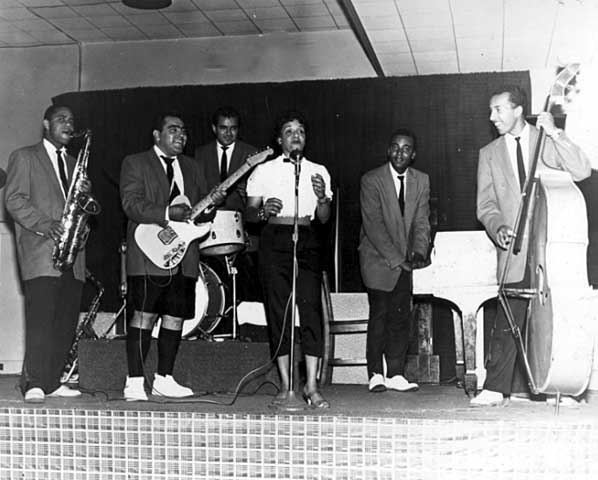
Augie Garcia and his band, 1955; photo courtesy Minnesota Historical Society
Bob Fernow:
I grew up on Watson Ave., a block and a half from the West Seventh Street Rec. It was a Bar/Bowling Alley/Café. They used to broadcast “Jackpot Bowling” from there on TV on Sunday nights and a lot of my friends used to set pins there.
It had the main bar in the front on the corner of West 7th Street, Tuscarora, and View Street. The door on West 7th went into the front main bar, then a wide door to the interior where the café was, and in the middle of the building before you got to the bowling alley was the lounge area where bands played.
I don’t remember the years exactly, but when I was a kid in the fifties/early sixties there was a huge picture of Augie Garcia that everyone knows, the one playing his Telecaster and wearing his Bermuda Shorts on the side of the building. It was up there for years even after he didn’t play there anymore, that I knew of anyway, since I was just a kid. I remember my aunt who lived pretty much across the street on Tuscarora Ave. telling me how popular Augie was and that when Augie played there, people were lined up around the block waiting to get in.
According to Landsberger, Al Danneker’s Cafe became Marge’s Cafe in 1967.
Bob Fernow:
The middle bar/Lounge area where Augie played wasn’t being used at all when I was old enough to get in there around 1970. It was a pretty big area with a good sized stage. It looked like a forties/fifties era small nightclub. From what people tell me, he played there quite a bit after the River Road Club burned down. Over they years they would have music acts occasionally but no one big like Augie and not as a regular thing.
The name of the bar was actually the W 7th Bowl when Mel Lipshultz sold it to Marv Cooper in 1970. Maybe they named it W 7th Bowl because it sounded a little more classy and because it was on TV a lot with the bowling show on Sunday nights. They had eight lanes and it was a nice place.
COOPER’S WEST
Bob Furnow:
After a mysterious fire, Cooper took the insurance and tore out the bowling alley and middle lounge and remodeled and made a night club in the middle area and changed the name to Coopers West, a name that we suggested to him because of the Fillmore East and West, we told him it would be cool to call it Coopers West.
Everyone always still called it the Rec even after Cooper had it. I remember that because after the fire – when people would call there, mostly wives calling to find out if their husbands were in there – every married guy in the bar would holler out “I’m Not Here” and Mac the bartender would answer the phone with “W 7th Bar” because the bowling alleys were gone and burnt down.
Cooper wanted a classy nightclub and he wanted a better, more respectable clientele than us (he called us drunken grubby hippies), but that was where he made all his money. Everybody in the neighborhood hung out there. It was the hottest bar on W 7th for a long time, and there’s a lot of bars on W 7th. It was basically a corner working man’s bar and he made a ton of money from everybody stopping in after work and beyond.
Cooper started booking country acts – Marvin Rainwater and Texas Bill Strength opened the club in July 1971, and Strength did some live radio broadcasts there, when he was a DJ for KTCR. A few national country acts like Webb Pierce also came through. Country didn’t work too well and he started booking rock bands and he cleaned up. He had some big local bands play there like Copperhead, they always packed the place. The rumor was he was gonna book Gypsy for New Years Eve and it was going to cost him $3 grand but it never happened.
He also had the Chancellors play there, and back then all the local Recs had talent night contests on different nights of the week and the Chancellors were the backing band for a while. There was group of people that would hit all the other bars’ talent nights. Sorta like Karaoke is now. My big claim to fame was I sat in with the Chancellors and jammed with them twice and won twice. First prize was ten bucks, not too bad for 1971, when a 12 ounce tap beer was a quarter and I think a drink was 35 cents. The Chancellors at that time only had one or two original members and they had a girl singer. Dan Holm, the bass player, switched to lead guitar, and I played his Telecaster.
The bar as Coopers West was only there until 1971 or ’72 and then it folded. Cooper was a bad businessman and got into too much debt. It was too bad because it was the coolest bar on West 7th, for a while anyway.
WEST 7TH HARLEY DAVIDSON
Landsberger:
West 7th Harley-Davidson moved into 1209 in the early 1970s and played a significant role in the Minnesota Motorcycling community. When motorcycles were starting to grow in popularity, Howard W. Belmont became passionate about the developing sport at a young age, and in 1939, Howard’s mother took out a mortgage on their home to set up show at 277 West 7th near downtown St. Paul. The site quickly became a community landmark, as well as the premier biker resource. They incorporated in 1945. The business thrived through the 1950s and ’60s, and in the early 1970s it moved to 1209. In 1981 Belmont retired and sold the business, which relocated off Highway 94 in Oakdale.
STRANSKY’S TODAY
The building has gone through a number of auto parts stores. As of 2020, it is part of the O’Reilly chain. This Google image shows the unusual shape of the building – basically a rectangle with a corner cut off for 7th Street.
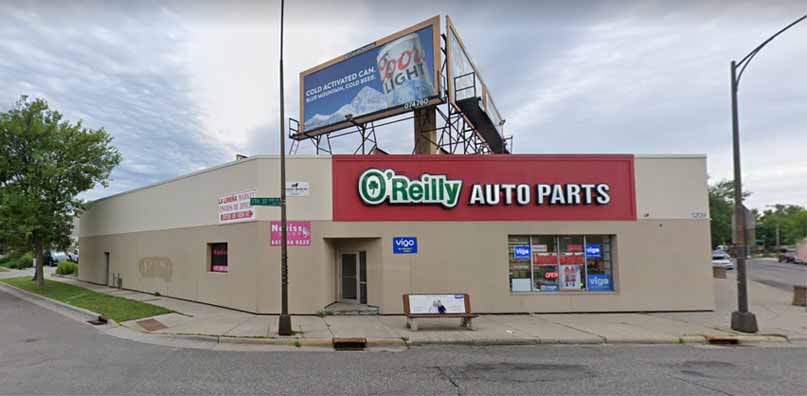
Thanks to Bob Furnow for all his help on this history!
Stub and Herb’s, at 227 SE Oak Street in Stadium Village, opened in 1939 and had entertainment in 1943.
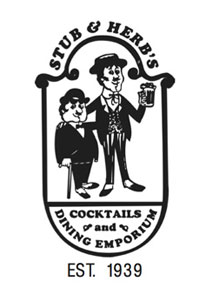
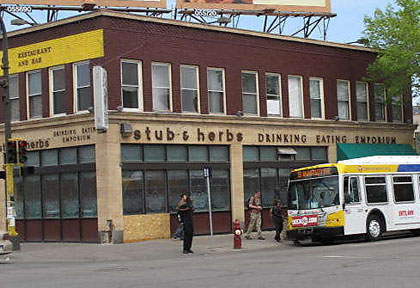
Bridges Nite Club – Rice Street and County Road F, St. Paul.
There was an ad for a “Cameo Midnite to Dawn Cabaret Dance” in the Minneapolis Spokesman for May 29, 1938. “Good Food! Good Music!” The 1939 event said that music would be provided by the Stumble Inn Swing Band, but that due to new Ramsey County closing laws, the party will not last til dawn as they had since 1930.
Sugar’s was located at 201 East Fourth Street in St. Paul, across from the Union Depot.
THE WANN BUILDING
Fortunately, this building was the subject of a City of St. Paul Heritage Preservation Commission Staff Report in conjunction with applications to renovate the building. The application is full of information and photos.
The brick building was built in 1879 (described as new that June in a tale of a teenage robbery). Wann was John Wann, described by the Minneapolis Daily Tribune on August 23, 1874, as “an old and wealthy citizen, whose name is a guarantee of good faith and honesty wherever it is known.” Wann had a lot of money and a lot of property and apparently spent most of his time buying, selling, and building on it. This particular building was designated for the wholesale drug company Noyes Bros. & Cutler. Wann was also involved with a great number of lawsuits, although they may have had to do with his development activities. He finished building his “block” along the north side of Fourth Street between Sibley and Wacouta, as reported by the St. Paul Globe on December 31, 1881.
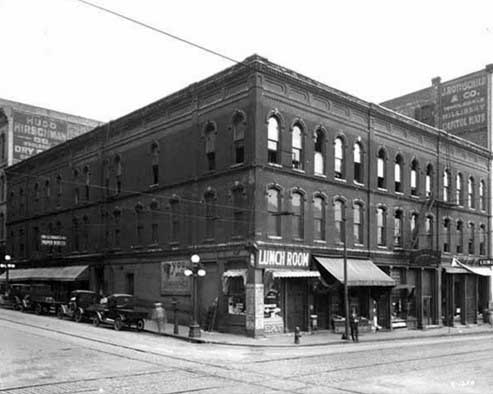
Wann Building before 1926. Photo courtesy Minnesota Historical Society.
A fire nearly destroyed the Wann Building, whose address was reported as 352 Sibley Street, on December 13, 1895. This became the address of the Straus Knitting Mills. Damage was estimated at $100,000. There were no fatalities. The roof of the building was burned off and the top floors were destroyed.
There was a fire in the building in 1903, but the news report did not list a lunch room or cafe as one of the seven merchants affected. One was a liquor store, and 207 E. Fourth Street was a hat shop, the proprietor of which had let his insurance lapse just a week prior.
It appears that the corner space was traditionally a lunch room, used heavily by the businesses in the area as it grew. Unfortunately this photo is too low-resolution to read the name of the lunch room.
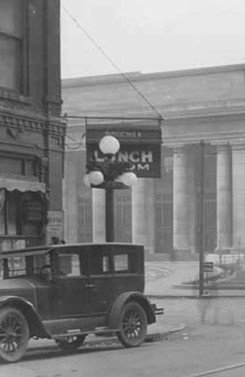
Photo courtesy St. Paul Heritage Preservation Commission Report.
John Wann died on August 23, 1905, leaving an estate of $181,000 to his widow. $180,000 of that was in real estate. His two daughters had moved to Germany and married Germans. His son lived in St. Paul.
1926
The building received a new façade in 1926 and clear historic photos of the 1926 storefronts have not been found. The entire 1879 exterior was removed as part of the 1926 renovation and replaced with an industrial window, storefront, and brick windows. The storefronts have been replaced many times since 1926 and historic images from 1926 are at a slant and difficult to see.
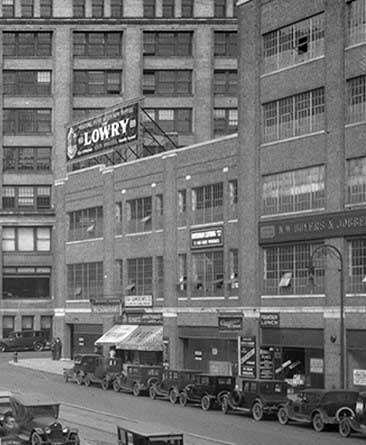
Wann Building after 1926 renovation. Photo courtesy Minnesota Historical Society
JOE DOTTY’S CAFE
After a number of searches under several names and addresses, the common denominator turns out to be Joe Dotty. Some of these different addresses and names may be errors in reporting. Chronologically we have:
In December 1943, as the operator of the Cozy Corners Cafe, Joe was given probation for selling Oleomargarine as butter. A more serious charge was that he was taking uneaten food off people’s plates and making something else out of them and selling it. That is kind of vague, but he was fined $25 for selling food that was not fit for human consumption.
In July 1944, he was identified as the proprietor of the Fountain Bar at 207 E. Fourth Street.
In June 1945, still at 207 E. Fourth Street, one reporter called Joe’s place the Stop Over Lunch, which a couple of robbers did.
In July 1945, he was identified as the proprietor of the Fountain Lunch at 207 E. Fourth Street. This was the scene of an ugly incident where a drunk and distraught patron was upset about being asked to leave at closing time, took out a knife he used to fix shoes, and slashed the bartender to death. Not realizing his bartender was hurt, Joe shut the door on the assailant, and the police had to track him down. He got 7 to 30 years at Stillwater.
By October 1945, the place was being referred to as Joe Dotty’s Cafe, although some lazy reporters misspelled it as Joe Doty’s Cafe.
SUGAR AND TINY
Sugar was Alex Viner, who was born to Russian parents who came to America in 1903. For some reason he wrote that he was born in Wells, MN on his World War II registration card in October 1940, but on all other Census forms it says that he was born in New York, in 1906. In 1920 his father was a bellboy at a hotel.
In 1935, the St. Paul directory shows that Alex Viner was the manager of the B & R Tavern at 645 Selby Ave.
Sometime between April and October, 1940, Alex married Arline “Tiny” Minnie Moberg. Tiny’s father was Swedish and had come to America in 1906; her mother was American-born. Tiny was born in 1913 and was a working girl – she was a “packer” in 1937, and “cutter of frost shields” in an automotive appliance factory just before she got married.
In October 1940, Sugar owned the Trocadero Cafe at 375 Wabasha, as he reported to the draft board.
SUGAR’S
At some unknown time between 1945 and 1950, the tavern at 201 E Fourth Street became known as Sugar’s. It was run by Sugar and Tiny, and was known for its fish fries, mashed potatoes, and onion rings. They would cash payroll checks for surrounding companies such as Toni, Rayette, the Great Northern Depot, the Post Office, and Straus Knitting Mills. All kinds of people would be seen in the bar/restaurant, and some employees would work 30 years or more.
Sugar died young, on May 10, 1950. Here is his headstone, via Findagrave.com Notice that it has a birth year of 1908, although he gave his birthdate as May 14, 1906 on his draft registration card.
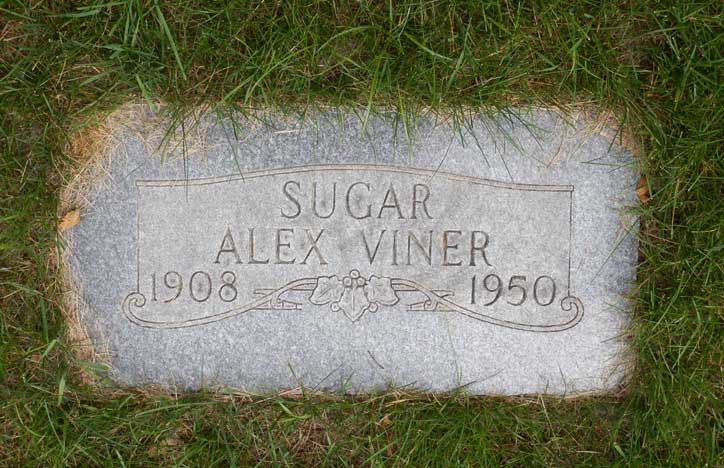
Courtesy Findagrave.com
Tiny carried on, with the help of managers Al and Libbie Sabes. In her obituary, Libbie was identified as a part owner until she retired. She died in 1975, at the age of 65.
Also helping out were the children of Sugar and Tiny:
- Connie, born in 1938
- Jimmy, born in 1943
- Ronnie, born in 1946
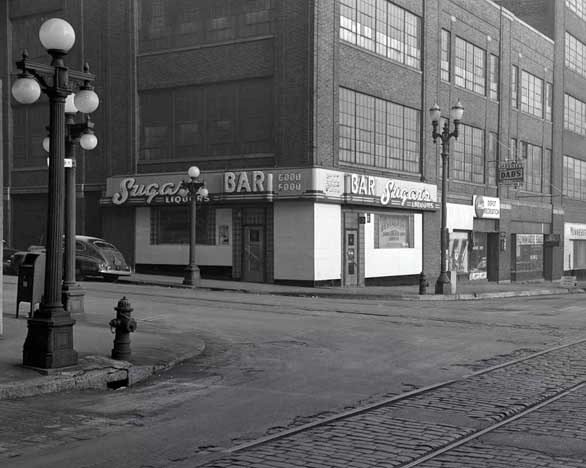
December 20, 1954 photo courtesy Minnesota Historical Society via Lyfmap.com
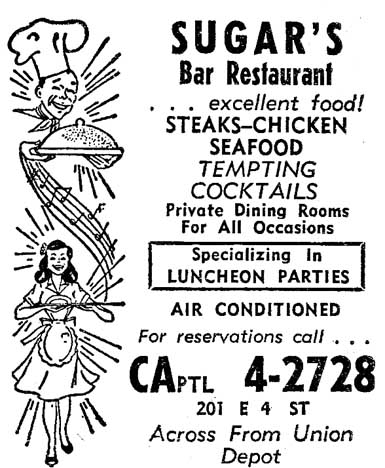
1956 ad courtesy Ron Ciccone
KID CANN AT SUGAR’S
Isadore Blumenfield, known as Kid Cann, was the most notorious gangster in the Twin Cities, but never seemed to do any time for any of his alleged crimes. He was accused of murdering journalist Walter Liggett in 1936, but dodged that charge. He ran the Minneapolis bootlegging Syndicate, but the Feds couldn’t catch him on that either. And he was certainly involved with the looting of the Twin City Transit’s streetcar system, but if he did the crime, others did the time. The only time he was caught with his pants down was for was for a Mann Act violation: persuading, inducing, enticing or coercing any woman to go from one place to another in interstate commerce, for the purpose of prostitution or debauchery, or for any other immoral purpose, whether with or without the consent of the woman. (Title 18, U.S.C.A. Section 2422).
Well, the Kid (or Fergie, as he preferred to be called), did a dumb thing. In May 1956, he spoke to a prostitute on the phone, and she flew from Chicago to Minneapolis and met him at the Kenesaw Bar on Skid Row. He told her to go to the Dyckman Hotel where he had made a reservation for her, and for $200 she did things she shouldn’t a oughta done.
In February 1957, she went before the Grand Jury and denied ever doing those nasty things. After perjuring herself, she went to Sugar’s Bar, where she met Fergie’s friend and told him what she had told the Grand Jury. The friend then called Fergie and all met back at the Kenesaw Bar where they told Fergie what she said. Her testimony didn’t hold water, since she had been a prostitute since 1953, was an alcoholic, had flown all over the country to ply her trade, and Fergie, through the friend, bailed her out of many bounced checks.
The upshot was that Fergie – Kid Cann – was finally convicted (of the Mann Act and conspiracy), and given the sentence of two years in prison and a fine of $2,500. The friend was found guilty of conspiracy and sentenced to a year and a day in prison for conspiracy.
And the prostitute? I don’t know if she ever went back to Sugar’s bar, but she did get married (four times) and died at the age of 58.
MUSIC AT SUGAR’S
It’s difficult to find many references to music at Sugar’s, but there is an occasional comment that someone played in a band there. It does appear to be a fairly large place, so there seems to be plenty of room for a bandstand and dance floor.
Mark Youngblood did find a blurb from 1960 described it as the Northwest’s most popular, Ultra-Modern Piano Bar, featuring Bette Kent. It served “Delicious Cocktails and Tempting Foods.” The source of the text is unknown but looks like it comes from a visitors’ guide.
If you have any more information about music at Sugar’s, please contact me! Thanks!
FUN AT SUGAR’S
In addition to the great food and music, Sugar’s seems to have been a fun place, as evidenced by the many souvenirs that people have hung onto and posted on Facebook. Here are a few.
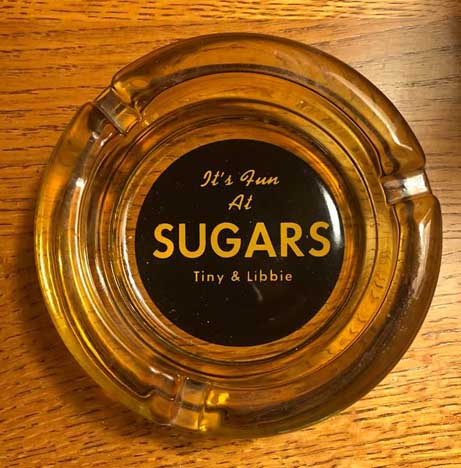
Ashtray posted by Jim Streadwick
Bottle opener/spinner posted by Ron Ciccone
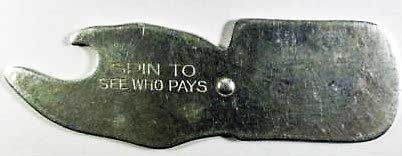
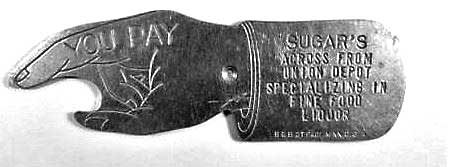
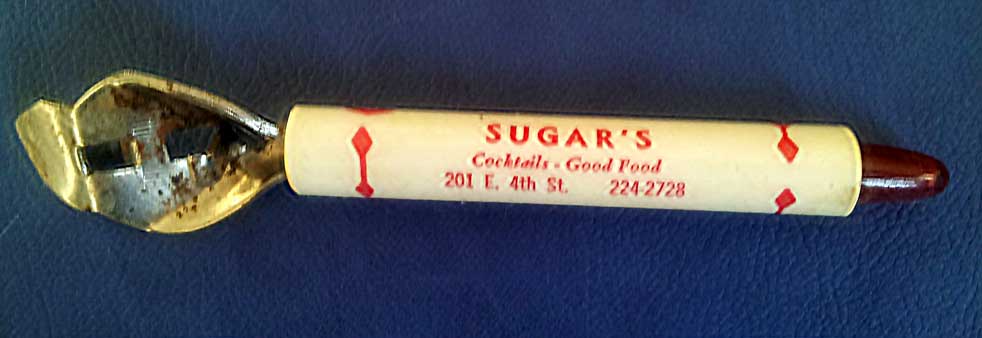
Bottle opener/phone dialer posted by Angelo Rulli
Matchbook image below courtesy Rick Schlosser
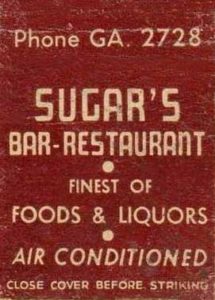
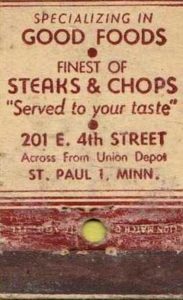
The end of Sugar’s came in October 1976, when it was purchased by Terry Ryan and was renamed Sibley Station. It underwent many other iterations since then, and now stands empty, ready for renovation into first floor businesses and upper floor flats. Dan Raschick took some photos of the interior demolition in about 2017 – this one shows the original brick of the building that somehow escaped the wrecking ball, to be used once again.
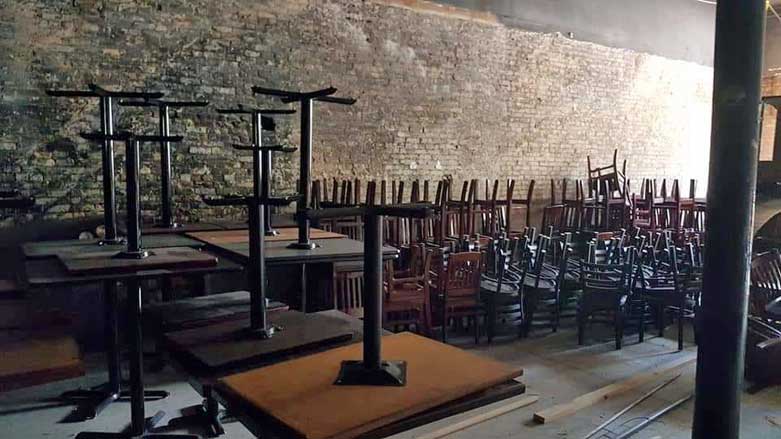
Courtesy Dan Raschick
Please see Shaw’s.
The Sunset Club was a night spot on Sixth Ave. No. in the 1920s.
The Superior Inn was on Superior Blvd. near Wayzata in 1927. Superior Blvd. became Wayzata Blvd. in the 1930s.
The Inn was “the rendezvous for a gay set of men and women;” perhaps a little too gay, as Sheriff Earle Brown and his goons saw fit to raid the place on June 25 of that year.
From the Hennepin County Enterprise, June 30, 1927:
Boulevard Inn is Raided; Men and Women Trapped
The Superior Inn, on Superior boulevard near Wayzata, and the rendezvous for a gay set of men and women, was pounced upon last Saturday night [June 25] by Sheriff Earle Brown, Captain Ray Goetze, and a squad of deputies.
An orchestra was playing and merriment reigned as the Sheriff and his men entered the place. Then confusion reigned. Men and women scurried for places of hiding, nearly all of them escorting a bottle of liquor. Several of the men attempted resistance and bottles ‘were aflying in the air’ for a while, resulting in a few broken heads. The beligerents were soon squelched. Earl Thompson was fined $100 as keeper of the place, and Arnold Frank, who played the role of Sousa to the orchestra, and E.W. Hicks were held on the charge of selling liquor.
The Surfside Supper Club/Restaurant, Lounge & Entertainment Center was located on Cook’s Bay, Lake Minnetonka, Mound. Directions at first were 1 mile south of Mound on Country Road 110. Eventually it attained the street address of 2670 Commerce Blvd.
The first we see it mentioned in the Strib is 1965.
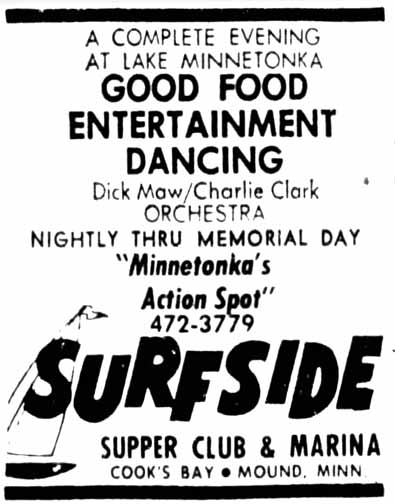
Minneapolis Star, May 25, 1967
On April 28, 1967, Will Jones wrote this in his column in the Tribune:
The Dick Maw-Charlie Clarke orchestra, all 14 pieces, now appears each Sunday evening 6:30 to 10:30, at the Surfside Supper Club in Mound. The dance floor overlooks Lake Minetonka, and dancing is encouraged. The band features arrangements of the Ellington-Basie genre, bit it also it also offers some big-band rock productions to appeal to the younger crowd. a smaller crowed from the band, five instrumentalists plus vocalist Carol Simon, will be featured Friday and Saturday nights starts starting May 5 and 6.
1971: The Zazz-Rock Sounds of Blue-Rokk Band (is that a typo or is there such a thing as Zazz Rock?). Also guitar sing-a-long.

Minneapolis Star, May 27, 1971
In 1973 folk group Easy Pickin’s performed on the Main Deck, and entertainers on the Top Side included Coal Duck, Brave New World, and Sinaloa. (or is that a bad spelling of Shangoya?)
In January 1974 Dale Thomton brought his own “vocal and 12 string guitar stylings to country-folk-rock as well as tunes from the ’50s and proved to be quite a balladeer with an original song.”
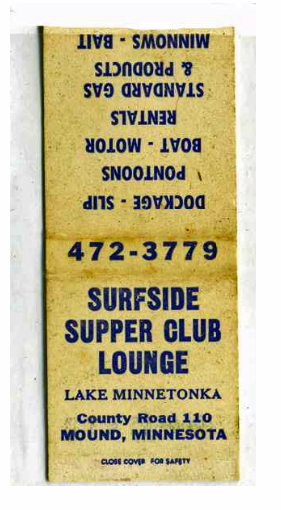
Matchbook courtesy Andrea Swensson
Surf was apparently up in May 1984. That address now computes to a condo, built in 1985.
Restaurant, Lounge, and Entertainment Center, Cook’s Bay, Mound. A June 1, 1967 ad in the Minnetonka Herald promised the Dick Maw and Charley Clark Orchestra, and on Sunday night a Big Band of 14 pieces featuring vocalist Carol Simon. Friday nights downstairs featured Red Gelhaye with Country Western music, and on Sunday afternoons enjoy the Surfriders, a Hawaiian Band. A January 17, 1974, ad in the Hopkins Sun features singer Dale Thomton.
Sutton Place may not have been Minneapolis’s first gay bar, but it was probably the most prominent. It was established in 1966 when it was still against the law to be a homosexual.
114 N. 7th STREET
The first location was in the Produce State Bank Building, across the street from First Avenue. The transfer of the liquor license showed that the license belonged to Evelyn H. Sutton. Jones said that “The bar had originally been Johnnie’s Lounge, then Sutton’s Lounge; Lockley’s crowd is calling it Sutton Place.” (My emphasis; some people remember it being called merely “Sutton’s.”)
I found a reference to a singer named Gloria Elwood singing at the Sutton Lounge in November 1952, but no address. There were no hits for Johnnie’s Lounge.
Another source called it “a quiet neighborhood bar in the Sumner/Glenwood area of North Minneapolis. It was an unpretentious establishment owned by a heterosexual married couple, Harold and Elizabeth Sutton.” I didn’t note the source and this doesn’t appear to be true.
“NEW PLACE TO CAMP”
Will Jones’s column of January 3, 1966, described the genesis of Sutton Place. It was purchased by “part-time TV personality, full-time hairdresser, and long-time Nicollet Av. character” Gordon Locksley and a group of “a group of Nicollet Av.-oriented partners.”
They opened it on New Year’s Eve, 1965, “after making a pass at redecorating the place by pasting up a lot of old movie posters with campy titles like ‘I Married a Queen’ and ‘Girls on Probation,'” said Locksley. “Nothing pretentious. It’s just a small, gay, side-street bar like you find in most of the the big cities.”
It was described as “Instant hitsville.”
“You never saw such a switch,” said Locksley. “Thursday night I went in, and there were a few couples sitting around. Friday night, the bar was filled with men, standing room only, and not a woman in sight. One couple did come in, and they seemed to enjoy watching the customers, but otherwise it’s been all boys.”
GORDON LOCKSLEY
The information below is a combination of information from three obituaries.
Gordon Allen Locksley was a hairdresser, private art dealer, collector of contemporary art, and bon vivant.
FAMILY
Locksley was born in Chicago on August 27, 1930, to William and Sheila Locksley (Lukowitz).
His grandparents, Isadore and Ella Lukowitz, came from Poland, emigrating before World War II. He was very close to his grandparents and his many aunts and uncles. His love for hearty, crusty breads came as the result of spending hours as a child at his grandparents’ bakery, which provided Chicago residents with their famous onion rye bread. He always told stories about his family, some rather humorous and always with love. Until he passed away, Gordon Locksley was the oldest member of the Lukowitz family.
His father worked in pharmaceutical sales for Max Factor and instilled a love of fragrances and their histories in his young son. His father listened to operas every weekend on the radio and Gordon learned how to appreciate and value great performances from his father, who won several telephone call-in contests. Gordon later developed a passion for Broadway musicals.
He was very close to his mother, who was a housewife. She and her sisters baked and canned vegetables together. Gordon learned his love of cooking from her and his aunts, especially his aunt Freda. Many of his friends have heard him tell stories and quotes from his aunt Freda. In fact, his family was filled with wonderful, caring members who helped Gordon become the man he became. Surrounded by his mother and aunts, Gordon was tutored in the art of cooking and acquired a passion for fine dining and entertaining, which lasted throughout his life.
As a teenager, he worked as an usher and in the cloak rooms of many of the theaters of Chicago which had live performances by famous people. Locksley fondly remembered meeting many who came through Chicago, most notably Sophie Tucker. He met and became friends with Jimmy Epenstein, who was a famous interior designer in Chicago. Mr. Epenstein took him to his first French restaurant where Mr. Locksley accidentally ordered scrambled eggs. Mr. Epenstein ordered the same. Later in life Mr. Locksley learned and spoke French and Italian fluently but always told the story of Mr. Epenstein with great fondness.
MOVING ON
Locksley moved to Columbus, Ohio for a brief time, and arrived in Minneapolis on a bus in a snowstorm wearing an opera cape. Never one to sit still, he checked into the YMCA and began working various jobs.
GEORGE SHEA
In 1954 he met George Shea who was an associate professor in Japanese language and literature at the University of Minnesota. In an era where it was literally illegal to be homosexual, Locksley and Shea were openly gay to the point where it was in the newspaper. Case in point: in an article about a break-in dated August 23, 1963, the account read that “Locksley and Shea were sleeping in an upstairs bedroom when the front door bell rang.”
RED CARPET
Locksley and Shea started the Red Carpet Beauty Salon and Red Carpet Beauty College at 925 Nicollet Ave., eventually locating it downtown on Seventh Avenue. Locksley styled hair for a living and on the weekends flew to national hair conventions for Revlon, demonstrating haircuts up on the turning stage for the attending hair stylists.
ART
Locksley later wanted to become an antiques dealer, but a friend, Jan Van der Mark, chief curator at the Walker Art Museum, encouraged him to look at contemporary art, which was just starting on the East Coast. He started selling posters out of the Red Carpet Salon walls to customers for $25.
LOCKSLEY SHEA GALLERY
The Locksley Shea Gallery began as a private gallery and became one of the leading contemporary art galleries in Minneapolis. It was located in his home on Mt. Curve Drive, which was where he and Shea lived and which they shared with the Colombian Consulate. Dayton’s 12 Gallery, headed by Felice Wender, was its main competitor. Miss Wender later became a very close friend of Locksley’s. The Locksley Shea Gallery was famous in the 1960s and ‘70s for its opening night parties with Minneapolis/St. Paul Society and contemporary artists all partying together. Artists such as Christo, Andy Warhol, Donald Judd, Brice Marden, Ellsworth Kelly and Robert Rauschenberg all came for the opening night parties of their exhibitions.
THE NIGHT OF THE WRAPPED NUDES
On December 15, 1967, Locksley invited 150 or so guests to a party to honor the artist Christo, whose specialty was to wrap things. In this case he wrapped two nude models in cellophane and tied them with rope. The seven-piece band the Perspectives played on the grand stairway of the main hall. Locksley said the party took four months to put together. From that night on, any reference to Locksley included a reminder of this epic party. (Minneapolis Tribune, December 17, 1967)
PARTY CENTRAL
Andy Warhol was the guest at a party on February 14, 1968; coverage mostly consisted of what the guests were wearing. He returned for a party on September 17, 1975.
The photo below is from a different party in 1969, attended by the beautiful people of Minneapolis. I’m guessing it’s our host, Mr. Locksley, in the silk pajamas, Hugh Hefner style.
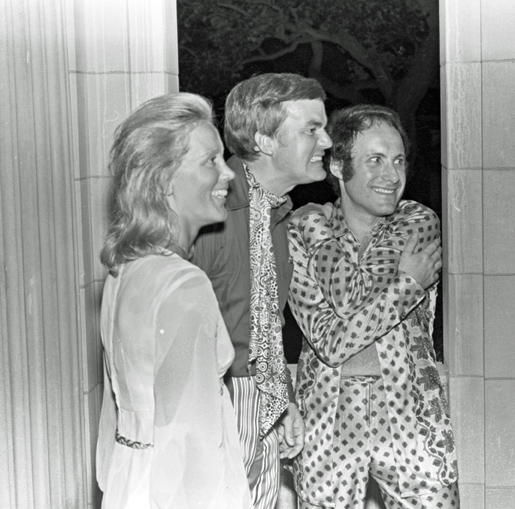
Photo copyright Mike Barich, St. Paul
LOCAL CELEBRITY
Locksley was a frequent guest on a local television program and participated often as host of a Minneapolis radio talk show. His knowledge and sense of humor attracted very large viewing and listening audiences.
Locksley hosted several auctions and fundraising events on public television in Minneapolis and St. Paul. He raised more money for the local public television station than any other host in the 1970s. In 1974, right after a historic snowstorm, Locksley sold a Chuck Close painting to a famous London collector over the telephone.
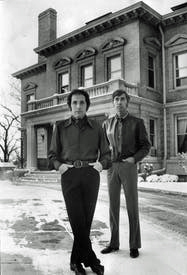
Minneapolis Star, November 23, 1969
LEAVING MINNESOTA
- In 1976 there was a downturn in the art market, and Gordon and George Shea decided to leave Minneapolis for Rome, never to permanently return. He was quoted as saying that “Minneapolis was like one big Kiwanis Club,” and that “I’ve always wanted to live in a world capital.” They sold the house at 1300 Mount Curve to Antioch College. They also sold the Red Carpet and Sutton Place.
- They next moved to Cannes, France and then to Paris.
- In 1994 they returned to the United States and settled in Palm Springs, in a Quincy Jones designed estate, which was featured in the movie “Oceans Eleven.”
- In 1998, Locksley met Wayne Boeck and they moved to Fort Lauderdale, Florida. They lived in a highrise on the beach and married in November 2013 when same-sex marriages became legal in the United States.
FORT LAUDERDALE
Locksley was very active with the Museum of Art Fort Lauderdale, loaning contemporary works of art for a private collector exhibition, “With You I Want to Live,” in 2010. He had also loaned works from his collection to the Minneapolis Institute of the Arts.
DEATH
Locksley passed away quietly in Fort Lauderdale on February 1, 2014, after a brief illness, at age 83. He is remembered for his keen wit and wry sense of humor, his thoughtful generosity and devotion to friends, family and the art world. He is survived by his spouse, Wayne Boeck, and long time partner George Shea. His wishes were that he not have a memorial service and that his ashes and those of a favorite pet’s be spread on the mountainside above Palm Springs, California. He felt that this was an appropriate ending for a life well-lived.
MEANWHILE, BACK AT SUTTON PLACE…
LIQUOR PERMIT TO BE REVIEWED
An article in the Minneapolis Star dated May 25, 1966, revealed that the bar was under tight scrutiny, with several complaints lodged against it by police to the City Council Licenses Committee. Those complaints included:
- beer had been given away free
- “suggestive language” is used
- “conduct of the patrons” is improper
- the bar is “suggestive of homosexuality”
- more than 90 percent of the dancing is “men dancing with men”
On May 8, the Morals Squad checked the bar, and found:
- men dancing with men
- men holding hands
- evidence of a beer lottery
- a 19-year-old woman drinking beer
As a result of the beer lottery and underage drinking parts of the Morals Squad report, the License Committee recommended a 15-day license suspension on June 8, 1966. This was approved by the City Council on June 10.
WHAT IS INDECENT?
The city attorney’s office was asked by the City Council Licenses Committee to furnish guidelines to the police as to what constitutes unlawful public behavior by homosexuals. “Eugene Wilson, head of the Police Morals Squad, said men had been observed in the bar dancing together, holding and and kissing, but that no arrests had been made for indecent behavior. He said it is difficult to determine how flagrant such conduct need be to justify an arrest. What we might consider immoral may not be illegal.” He was also quoted as saying that although homosexual acts are illegal even in private, his staff “has better things to do.”
Assistant City Attorney Dabe Shama said “it probably isn’t indecent for men to dance together, but if he were a judge he would most certainly consider it indecent if they held hands, kissed or made suggestive movements.'”
Two other bars known to attract homosexuals have also been under surveillance but that no violations have been observed.. One alderman stated “I don’t know either where to draw the line between morality and immorality. None of these places are houses of worship.” Wilson said that “although homosexual acts are illegal even in private … ‘We couldn’t care less what one’s sexual philosophy is.’ Wilson said his squad makes about three or four arrests of homosexuals a month, mostly men dressed in women’s clothes in violation of a state law against concealing identity.” (Minneapolis Tribune, June 9, 1966)
The article in the Minneapolis Star on June 10 reporting the suspension indicated that there were two other gay bars in town.
In August 1974, it was reported that that the Sutton Place bar had expanded into space formerly occupied by a Chinese cafe and was now serving the best bargain lunch Downtown.
Facebook memories are that this first location was dark and small.
The earliest we find this address is June 1977, although April 1976 is probably closer to to the date of the move. One commentator on Facebook described the building as the old Litton microwave factory. Click the link above to see the many other venues in this spot before and after Sutton Place.
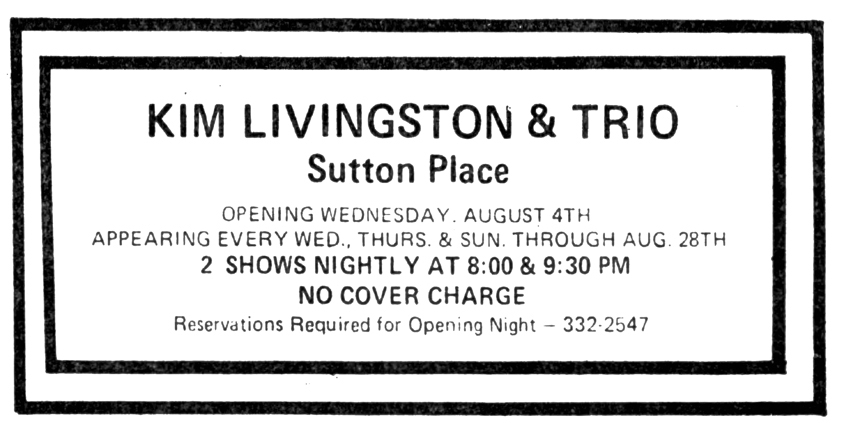
Minneapolis Star, August 1, 1976
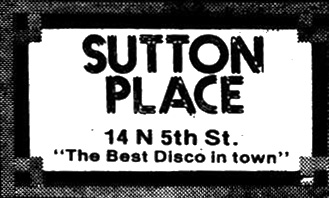
1977 ad from Minnesota Daily courtesy Alan Freed
THE PESIS FAMILY
From at least April 1976, the owner of Sutton Place was Ernie H. Pesis. Ernie had owned the State Bar at 205 Nicollet, in Skid Row, from at least 1950 to 1954. It was demolished in 1961.
During the 1977 Minneapolis Mayoral campaign, Ernie was accused of asking his employees and some customers to make campaign contributions to Albert Hofstede, and Pesis would reimburse them with funds from the bar. State law and a city ordinance prohibit the use of corporate funds for campaign contributions.
Ernie’s son Ron Pesis also owned clubs in Minneapolis.
- April 1976: Ron owned Othello on Hennepin Ave.
- August 1979: Ron owned the Saloon
- Ron owned the gay bathouse/sauna the Locker Room Baths. It was famously raided on December 1, 1979.
Facebook memories of the second location:
- Sutton Place was THE disco to be seen in. It was glam to the hilt and the music was amazing.
- Sutton Place was the Studio 54 of Minneapolis.
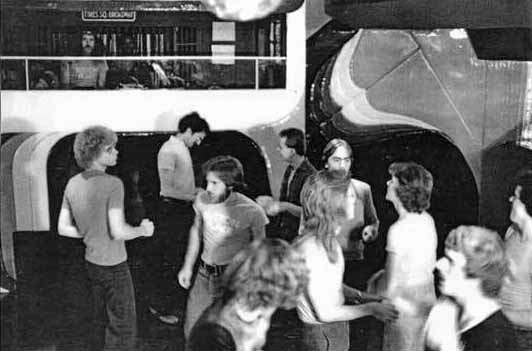
Old Minneapolis Facebook photo from 1976
A disco guide in the Minneapolis Tribune dated November 4, 1977, described Sutton Place as:
Fast becoming a favorite of many black disco goers in the Twin Cities who have found there are no hassles at the door if you look of legal age. A mix of whites, blacks, gays, couples, and singles usually frequent this disco during the weekend. If you want to site down, you’d better come early. The light show is very good. People tend to dress up on the weekends. There also is a live band downstairs on weekends.
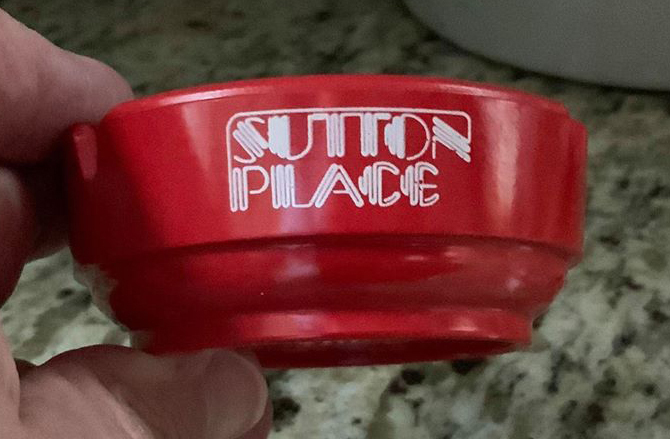
Image courtesy Ray Smith
At the end of December 1977 the Club had been “revamped,” and the Suicide Commandos were performing at the New Year’s Eve party.
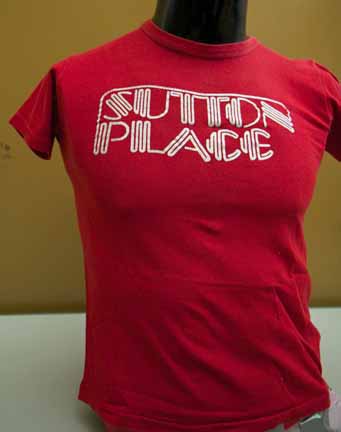
SUTTON PLACE OPENS AGAIN
An article in the Minneapolis Star dated February 24, 1978, catches us up on what’s been happening at Sutton Place.
In the past year or so, it went from a gay bar to a straight bar to an empty bar.
NEW OWNERS
New owners Charlie Senkler and Richard Giffin took over on January 1, 1978. They were aiming to attract upper income chic gays, to the point where straight couples were treated poorly. Star reporter Joe Logan and a female reporter “experienced a variety of tactics” to discourage them from future visits. A request to strengthen a weak drink was refused. They were accused of calling one of the waiters “a queer.” Another mixed couple next to them was told they had to order drinks or leave their seats. They were on the verge of being asked to leave by the owners until they identified themselves as reporters.
Logan described the layout of the newly-redesigned bar:
The two-story bar and disco has had no major structural changes. The downstairs area now is called the Palm Court, a bar and sitting room particular for gays, in a small, adjoining room is a dance floor with mirrored walls and music piped in from the disco on the second floor.
True to its name, the Palm Court has an abundance of plants, in addition to wicker and chrome furniture, bleacher seating and bars on both sides of the room. On the entryway walls are photos of scantily clad gay couples embracing. Also downstairs is a separate room with a bar.
Upstairs, in a larger, L-shaped room, is a disco featuring a stainless steel dance floor, five overhead mirror balls, tracers and strobes. Along the walls are three levels of bleacher seats and two more bars. Plans also call for audio-visual recording systems that will film dancers for playback later.
In a 1979 article, Karin Winegar reported that former Sutton’s lost its gay clientele by exploiting it with inflated prices and alienated straights by being rude to women who arrived with men. State records showed that three complaints were filed against Sutton Place from 1976 to 1978: one refusal to hire and two harassments of patrons. (Minneapolis Star, January 26, 1979)
ANOTHER NAME CHANGE
In September 1979 the name of the club was changed to the Fox Trap.
SHORT HISTORY OF LGBT LAWS IN MINNESOTA
Wikipedia:
Lesbian, gay, bisexual, and transgender (LGBT) persons in Minnesota have the same rights and responsibilities as non-LGBT people. Minnesota became the first state to outlaw both sexual orientation and gender identity-based discrimination in 1993, protecting LGBT people from discrimination in the fields of employment, housing and public accommodations. Minnesota is frequently referred to as one of the United States’ most LGBT-friendly states.
In 1849, the Minnesota Territory was given Wisconsin’s laws, including a ban on heterosexual and homosexual sodomy, which was defined by the common law. When Minnesota drafted its own criminal code, it kept this prohibition. In 1921, it expanded the definition of sodomy to include fellatio as well as anal intercourse. Beyond the criminal laws, vagrancy laws banned anyone from soliciting for “immoral purposes.”
In 1939, a wave of child molestation cases in St. Paul led to the enactment of a psychopathic offender law, which included LGBT people alongside rapists and child molesters. Though justified by the need to protect children and others from sexual abuse, those convicted of homosexuality constituted the major part of those imprisoned under it.
In 1967, the penalty for sodomy was reduced from a felony to a misdemeanor, punishable by up to one year in jail and/or a fine of $1,000.
In 1972, Jack Baker filed a lawsuit against Gerald R. Nelson after being denied a marriage license. The case resulted in the Minnesota Supreme Court ruling that Minnesota law limited marriage to opposite-sex couples and doing so did not violate the State Constitution or the United States Constitution. Although Baker subsequently appealed to the U.S. Supreme Court, his appeal was dismissed with a one sentence ruling.
An attempt to repeal the sodomy law failed in the Minnesota House of Representatives in 1973 by a vote of 69-46 with 19 abstentions.
In State v. Blom (1984), the Minnesota Supreme Court ruled that the criminal ban on sodomy also applied to the act of cunnilingus. A few years later in State v. Gray, the Court rejected the argument that privacy rights applied to sodomy involving prostitution. However, the court did recognize that the State Constitution protected privacy rights, although it stopped short of stating whether or not private, adult, consensual and non-commercial sodomy was covered under the State Constitution’s right to privacy.
In 1989, Minnesota laws were expanded to cover hate crimes on the basis of a person’s sexual orientation.
In 1992, Governor Carlson signed an executive order that prohibited discrimination on the basis of sexual orientation in state employment.
In 1993, sexual orientation was expanded to include the category of gender identity.] The law provides additional penalties for a crime committed based on the victim(s)’ sexual orientation or gender identity, alongside other categories such as race, religion or sex.
In 1993, Minnesota amended its statutes to prohibit discrimination on the basis of a person’s sexual orientation and/or gender identity in housing, insurance, goods and services, contracts, health benefits, hospital visitation rights, and employment.
The 1993 Minnesota Human Rights Act uses the following definition with regards to the phrase “sexual orientation:” “Sexual orientation” means having or being perceived as having an emotional, physical, or sexual attachment to another person without regard to the sex of that person or having or being perceived as having an orientation for such attachment, or having or being perceived as having a self-image or identity not traditionally associated with one’s biological maleness or femaleness. “Sexual orientation” does not include a physical or sexual attachment to children by an adult. The law does not apply to religious organizations, youth groups and certain small businesses.
The 1993 addition of sexual orientation to the Minnesota Human Rights Act also included the insertion of the following quote, part of which is still in force as of 2020:
363A.27 Construction Of Law.
Nothing in this chapter shall be construed to:
(1) mean the state of Minnesota condones homosexuality or bisexuality or any equivalent lifestyle;
(2) authorize or permit the promotion of homosexuality or bisexuality in education institutions or require the teaching in education institutions of homosexuality or bisexuality as an acceptable lifestyle;
(3) authorize or permit the use of numerical goals or quotas, or other types of affirmative action programs, with respect to homosexuality or bisexuality in the administration or enforcement of the provisions of this chapter; or
(4) authorize the recognition of or the right of marriage between persons of the same sex.
No bill has been introduced to repeal this law as of yet.
In Doe et al. v. Ventura et al. (2001), Minneapolis Judge Delilah Pierce ruled that the sodomy law violated the State Constitution when dealing with private, adult, consensual and non-commercial sodomy. The ruling was later certified as being a class action lawsuit and the State did not appeal, thus voiding the law in terms of private, consensual, non-commercial acts of sodomy by consenting adults. No bill has been introduced to repeal Minnesota’s sodomy law.
On November 6, 2012, Minnesota voters by a margin of 51.5 Percent to 47.5 Percent with 1 Percent abstention defeated a proposed amendment to the State Constitution that would have banned same-sex marriage in Minnesota.
On February 28, 2013, a bill was introduced in the Minnesota Legislature to legalize same-sex marriage in the state. On May 9, it passed the House of Representatives by 75-59 votes. On May 13, 2013, the Senate passed the bill by a vote of 37-30. Governor Mark Dayton signed the bill into law on May 14; same-sex marriage became legal and recognized in the state on August 1, 2013.
Though legislation outlawing same-sex sexual activity remains on the books, it has not been enforced since 2001 when the state Supreme Court ruled it unconstitutional.
Swede’s 1311 Club was located at 1311 Lake Street in Minneapolis.
THE BUILDING
According to the building permit file, the building was built in 1911 as a 28′ by 85′ brick store building.
One of the first uses of the building was the West End Laundry, which advertised for women to wash clothes for years, starting in about 1912.
Another early resident was Anderson Auto Trunk, Ernest Anderson, Proprietor. Here’s a picture of Mr. Anderson from a full-page presentation of city leaders.
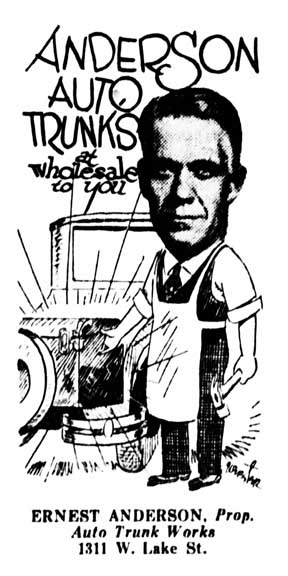
Minneapolis Star, August 12, 1929
1311 CLUB
In October 1935, soon after the end of Prohibition, H.J. Carr converted the place into a tavern, and its various proprietors seemed to get into trouble on a regular basis.
Carl Chalfen ran the place in 1939, and was fined $25 for maintaining a gambling device, and $50 for two counts of selling beer to a minor.
In February 1940, Peter S. Boardman spent 30 days in the Workhouse for maintaining a gambling device.
In March 1940, Roy M. Thelen had his license suspended for 30 days .
In September 1941 the proprietor was Charles Youngman.
In November 1943 the place was for sale.
SWEDE’S 1311 CLUB
It appears that “Swede” was William Anderson, who owned the bar for 16 years. He made $7,000 in alterations to the place in 1949. He put it up for sale in August 1956; the ad said he was leaving the state.
It became Swede’s Tavern, advertised as such in October 1957.
Augie Garcia and his Quintet entertained at Swede’s in July 1960. Augie had also established a judo club in the basement of Swede’s, where he held demonstrations between sets.
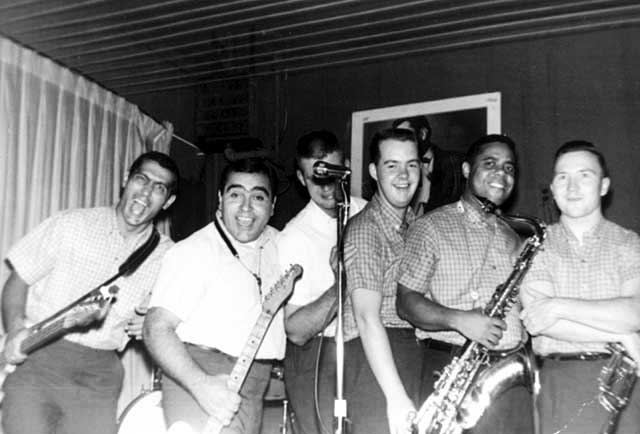
Augie and Quintet at Swede’s, 1960. Photo courtesy Minnesota Historical Society
At some point it was called Swede’s 1311 Klub Bar.
In May 1969, furniture auctions were held in the basement of Swede’s.
The name Swede’s was last used in wantads on March 18, 1973.
No name was given from June 29 to July 3, 1973.
CASEY’S 1311 BAR/KLUB
Starting on October 16, 1973, the bar began to call itself Casey’s in its ads for staff. This went on until March 14, 1974.
FIRE
On November 21, 1975, a two-alarm fire broke out at 4:40 am. The property was demolished in December 1975/January 1976. It remains vacant land next to Calhoun Square with the address 1301 W. Lake Street.
Swing City was located at 1682 Rice Street, across the street from incorporated St. Paul.
Bob Patrin has done a great deal of research on this place; these are notes from conversations with Bob, augmented with research through the StarTribune archives and ancestry.com.
CITY LIMITS TAVERN
Bob said that the bar went back to about 1928, owned by a man named Harry Quatman. It started as a garage, then branched out to sodas, then to the City Limits Tavern, probably in 1933 at the end of Prohibition. News reports from November 1937 name Harry Quatman as the proprietor of the City Limits Tavern.
SWING CITY
Perhaps as a result of Quatman’s trouble serving beer to minors, the bar may have changed hands and names. The 1940 Census lists Quatman’s occupation as the owner of a beer place, but we don’t know if it’s this one.
A note in the Minneapolis Star said that the University crowd were flocking to Swing City in October 1937.
Jan Pongalos was named as the proprietor of Swing City when the place was raided in November 1942.
The photo below is El Herbert, Swing City’s house band in the ’30s.
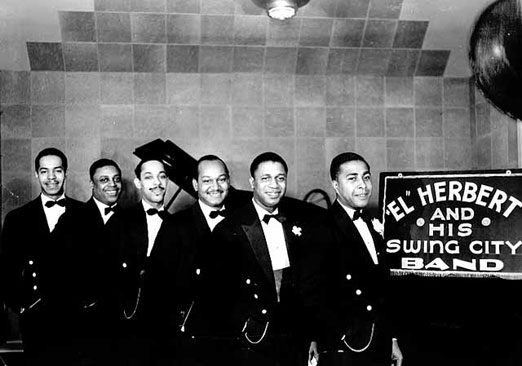
Photo courtesy Minnesota Historical Society
FRANK AND MARIE’S
Quatman lost his liquor license, just at the same time that Patrin’s uncle, Frank Fietek, was discharged from the Army. Fietek was 38 when he registered for service in WW II, which was clearly stated on his form, but he only served six months and was discharged on March 31, 1943. Bob speculated that Frank was found to be too old. Frank received a certificate to start a business, and he took it to City Hall with the intent to own a tavern. He was given Quatman’s license and took over Swing City, renaming it Frank and Marie’s Tavern, after himself and his sister. Quatman had been given only three days to vacate, and evidence found in the garage indicated that it had been used as a brothel. Years later they discovered a “14 Board,” the most popular gambling game in the Twin Cities. Bob says that one band that played at Frank and Marie’s was Bob Smith and His Hawaiian Steel Band.
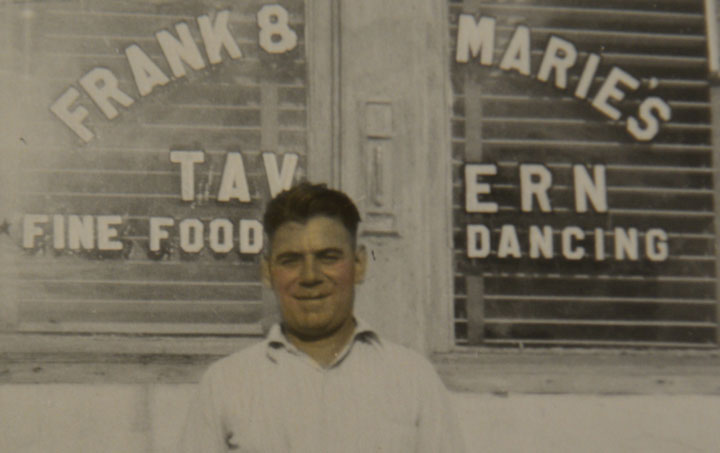
Frank Fietek in front of his tavern. Photo courtesy Bob Patrin via StarTribune
The mobsters were ticked off. Although they were hanging out at Happy Hollow across Rice Street, they wanted control of Frank & Marie’s as well, and were incensed when Frank turned down $2,000 in cash that his bagmen had offered him for the place. They offered “insurance,” but Frank declined. The bagmen tried to get to Frank through Marie by giving her an expensive alligator bag, but Frank still said no. Frank – whether on purpose or unwittingly – even riled the mob when his ad in a Hudson’s map was bigger than that of the mob-run McCarthy’s in St. Louis Park.
One night at closing in late November 1943, the bagmen kidnapped Frank, took him out to Rice Street and McCarron’s Blvd., broke both his legs, and left him on the road to be run over. Fortunately the speed limit was only 35, carefully watched because of wartime restrictions, and he was found by the Sheriff and taken to the hospital. But he could never walk again, and was taken to his brother Harry’s house at 120 Carroll Ave.
THE LAKEVIEW
The tavern was immediately renamed the Lakeview – Frank didn’t want Marie to be in peril. But in November 1945 the basement of the tavern was torched, causing $2,500 in damage. Frank closed it for good but still wouldn’t sell. Finally, on March 4, 1946, the bagmen went to where Frank was staying, dragged him to the basement, stood him on a woodpile, put a necktie around his neck (which he never wore), attached it to a wire, and kicked the wood away, virtually lynching him. Bob said the coroner never came, but the Minneapolis Star reported that the Ramsey County coroner was investigating Fietek’s death. Bob also said that no autopsy was done. In any case, it was deemed a suicide. Bob said that two weeks after Frank was murdered the bar was miraculously reopened – as Swing City.
From the Minneapolis Tribune of September 9, 1946, we learn that about a dozen men came to the Lakeview at closing time and started a near riot, sending four patrons to the hospital with cuts and bruises.
That’s the way Bob tells it, anyway. He has other details that have to do with the murder of journalist Arthur Kasherman, and somehow Kid Cann blamed Frank Fietek for Kasherman’s expose of corruption in Minneapolis politics, but I didn’t quite understand that. More details can be found in James Eli Shiffer’s article in the StarTribune.
The Swingin’ Door Saloon at 26th and Nicollet advertised the Voodoo Men with dancing nightly in February 1963.
The Swiss Chalet at 5201 Excelsior Blvd, in the Miracle Mile Shopping Center in St. Louis Park had live music 1972-74.
Sixth Street just off Hennepin Ave.
This page is about the many clubs that were located at 14 No. Fifth Street in Minneapolis, in the Warehouse District of Downtown.
ANCIENT HISTORY
The three-story building goes back to 1884, according to Minneapolis building permits.
Newspapers show it was Dickens and McCague’s Livery Stable in January 1886 and a glass company.
In 1891 it must have housed apartments, as cases of measles were reported.
In May 1898 the wallpaper business in the basement went up in flames; the Tribune’s headline read “Was Warm for a Time.”
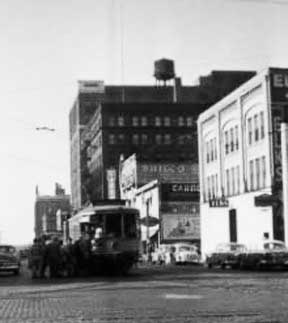
Building on far right
In 1903 – 1906 it was Rimal Zieve’s grocery store (across from the West Hotel), getting robbed a lot.
In 1908 it was described as the Levi M. Stewart Building, 67 x 100. It was reported that Simon Ravicz leased the building for 10 years and would be remodeling the first floor into three stores and the second and third floors into a hotel. (Minneapolis Tribune, July 24, 1908)
In July 1935 it was a restaurant owned by Hyman Polski of St. Paul. In 1929 Polski had been sent to Leavenworth for two years for being involved in a 70,000 gallon distillery in Rosemount in 1926. Here’s more information on Mr. Polski.
I. Wolk had a special food permit in May 1936 for 12 – 14 Fifth Street N.
MODERN VENUES
- The Gold Bubble Cafe: 1934 – 1939
- Andy Leonard’s: 1941 – 1945
- Leo ‘n’ Eddie’s: 1946
- Elk’s Club: 1948 – 1968
- Tafi’s: 1971 – 1972
- Sutton Place: 1976 – 1978
- Fox Trap: 1978 – 1980
- Wells Fargo Saloon and Way Station: 1980 – 1981
- Taste Show Lounge: 1981 – 1984
- Jukebox Saturday Night: 1984 – 1992
- Grafittis: 1995 – 1997
- The Deep End: 1997
- Sneaky Pete’s: 2007 –
THE GOLD BUBBLE
One of the hundreds of “Nite Clubs” that opened after Prohibition ended was the delightfully-named Gold Bubble Cafe.
This is as much hoopla as I’ve seen for a little post-Prohibition place. Despite its high profile location, there didn’t seem to be any trouble … at the Bubble.
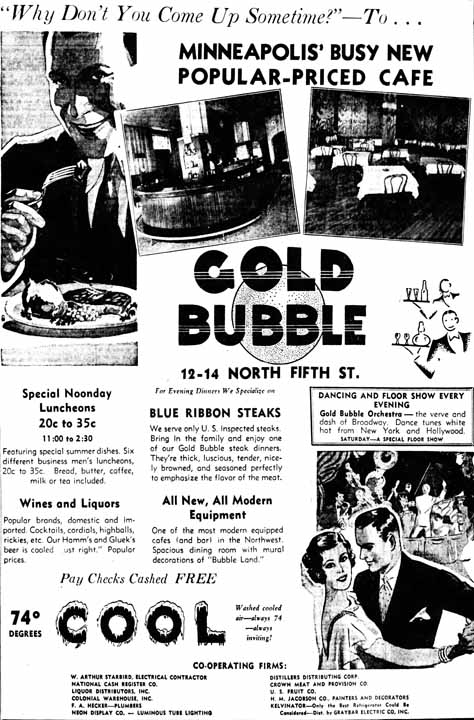
July 7, 1934
An article written in the first person but without a byline introduced us to proprietor Sam Gorman, age 35, who got tired of being a furrier. (Saturday Press, July 21, 1934)
I want you to go and see it. I want you to meet Sam. I want you to listen to the excellent orchestra; dance under the revolving lights; feast your eyes on the magnificently hand painted walls; eat the finest food you ever tasted and –
Rest your elbows on the only “horse-shoe” bar in the city. That bar alone is worth walking from St. Paul to see.
The “Gold Bubble.” Sam must have dreamed that name. I hope his dream comes true.
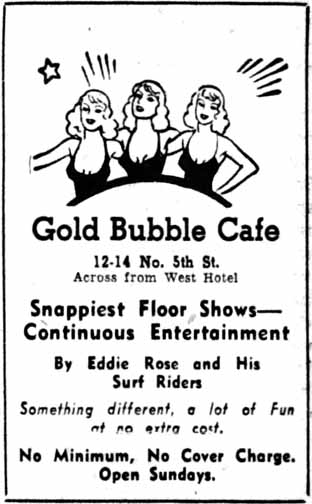
September 29, 1934
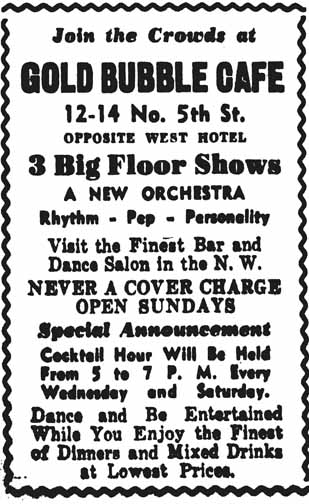
November 24, 1934
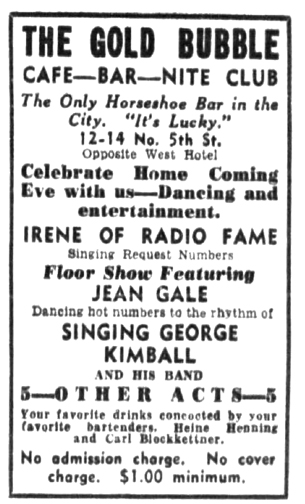
Minneapolis Tribune, October 26, 1935
On April 21, 1939, Hennepin County Sheriffs raided the Gold Bubble and took proprietor Marie Critelli into custody for maintaining gambling devices, specifically “chuck-a-luck” and Bingo. The case was dismissed when it was pointed out that there was a partition between the gambling area and the bar!
In June 1939 the establishment went up for sale.
The Gold Bubble had a great bowling team and was often in the Minneapolis papers with their scores.
ANDY LEONARD’S GAY NINETIES
Andrew A. Leonard was the former proprietor of the Harbor Bar/Club Lido at 507 Hennepin Ave. He got his license for the 5th Street address in June 1940. He opened the Gay Nineties by January 1941.
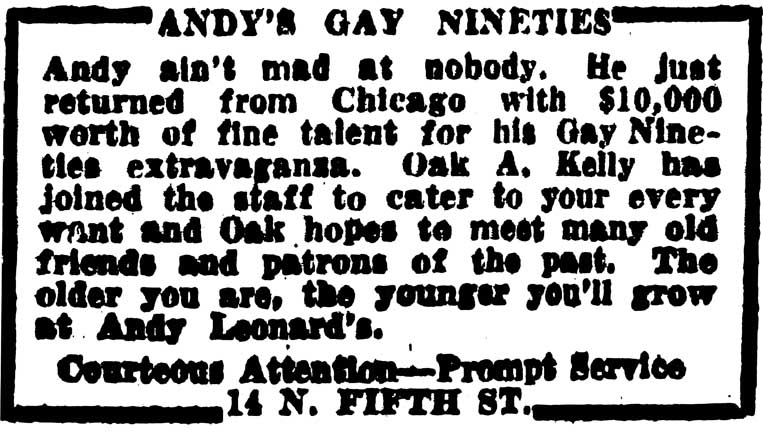
Minneapolis Star-Journal, March 15, 1942
Cedric Adams reported that on January 10, 1944, the place “should take on a strange atmosphere.” I bet it had one already. Anyway,
Along with Andy’s Gay Nineties Revue will be an act featuring the Montana Kid and Coley Bay, America’s most educated horse. They say the Kid and the animal sit down at a table together, eat, drink, and visit.
On July 24, 1944, a benefit performance at the veterans’ hospital was held with performers from Andy’s Bar, including the Montana Kid and Coley Bay, the Campbell Sisters, and tenor Joe Griffin.
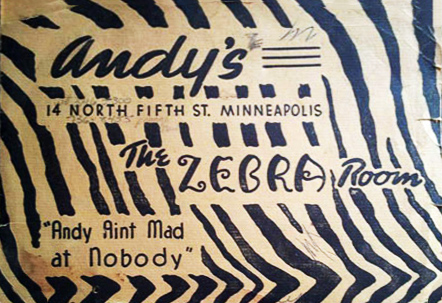
Image courtesy Alan Freed
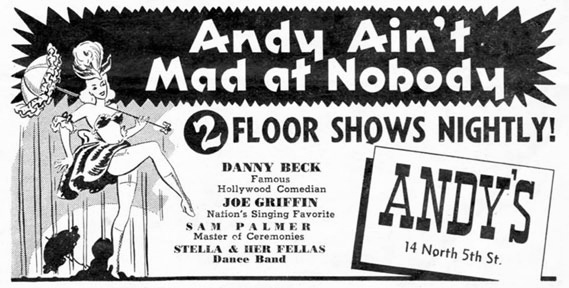
1944
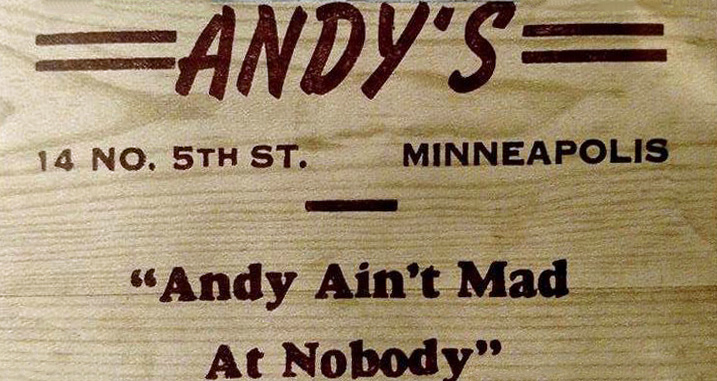
Image courtesy Nate Jorgenson
In May 1945, gambling crusader Rev. O.S. Winther reported that he caught people playing the dice game California at Andy Leonard’s. Andy’s is last seen in July 1945.
LEO ‘N’ EDDIE’S
This was an apparently short-lived establishment, spotted in the papers from February to July 1946. It was owned by A.E. (Eddie) Holman, former Mid-Continent Airlines pilot, and Leo Haydnet, “Former Fertile, Minn. mercantilist.” Cedric Adams reported in his column that they planned to have larger name bands and two-act floor shows. (Minneapolis Star-Journal, February 12, 1946)
ELKS LODGE
The building was purchased by the Minneapolis Elks Lodge No. 44 from Leonard in January 1948 for $80,000. The liquor ordinance had to be amended in order for Leonard’s license to be transferred to the Lodge. In April 1968 the Club put the building up for sale, with the provision of leasing back the second and third floors. It remained the Elk’s Club until about October 1968.
TAFI’S
In late July, 1970, the entire building was taken over by James Theophilius Aladubi Babington-Johnson, Jr., known as Tafi. Tafi had been a dining car waiter for the Great Northern Railway, got a degree in political science and worked for Honeywell and the Institute of African-American Studies.
Tafi’s opened on January 4, 1971. The club was a restaurant/supper club featuring live jazz and folk. Ahmad Jamal Trio played at the opening, and Young/Holt Unlimited did two weeks at the end of 1970. The Insider described it as a “Playboy-type operation.” Jazz just didn’t bring in customers and it closed after three months.
An article from July 1971 said that brothers Danny and Gary Stevens were trying to line up financing to buy it and convert it to a rock venue called the Fillmore, but it was gone by 1972.
SUTTON PLACE DISCO 1977-1979
Please see Sutton Place
FOX TRAP
Transition from Gay to Black Clientele
Fox Trap opened in September 1978. It was owned by Ernest Pesis, who had owned Sutton Place. Sutton Place had been reportedly losing its gay clientele by exploiting it with inflated prices and alienating straights with rude behavior that brought three official complaints from women to the State Department of Human Rights. Manager Allen Bloom explained that the name of the bar changed to get away from the gay image, which was not that profitable anyway.
Fox Trap quickly developed a predominantly black clientele, reported the Star‘s Karin Winegar in 1979.
Ernie Pesis was quoted as saying that he did not change the character of the bar: “It changed itself. It weeded itself out: The gays left ’cause they thought there were too many straights and the straights left ’cause they thought there were too many gays.” He did like the name change of the bar, though. But Manager Bloom said the name was changed to get away from the gay image, and the lineup of disc jockeys was changed from multiracial to black.
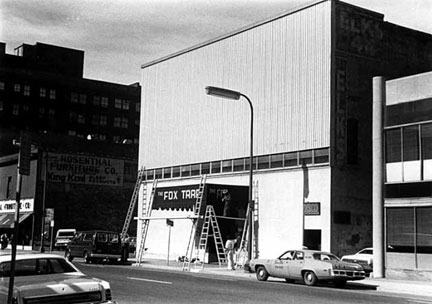
An anonymous letter dated September 18, 1978, written by a U of M student (taking “Comp-Eng” but apparently not too far along), has this:
The owners of Suttons sold out its a strictly Black bar so I have not been in there since the change and I won’t.
The Palm Court
The club was on two stories, with the Palm Court Lounge on the first floor. This was described as having turquoise-carpeted banquette beneath a silver Art Deco ceiling, a small mirror-walled dance chamber, a Victorian-style oak bar, chandeliers and fireplace. This rooom is a retreat for conversation or listening to jazz. On Sundays, Morris Wilson’s Trio backed singer Roberta Davis in the Palm Court. On Mondays, jazz musicians stopped by for a jam session. (Minneapolis Star, January 26, 1979)
The Upstairs Disco
An article headlined “Hennepin Avenue: She’s not a lady” by David E. Early of the Minneapolis Star described the various entertainment venues on and proximate to the City’s main party street. Although Fox Trap was technically not on Hennepin Avenue, Fox Trap was “definitely part of the weekend milieu of the avenue,” he wrote.
The Trap is a sumptuous black disco where peace-lovers can whisper in cool tones downstairs and real hardy partygoers can fry shoe soles on a stainless steel floor upstairs. An orange neon sign in the upper Trap implores all present to “Dance Yore Ass Off.” Friday night no urging was needed to press the black crowd into service at one of the few places in Minneapolis catering to blacks.
“It’s a ripoff,” said one brother, who was on his way in after paying the $3 entrance fee, “but so many fine women come here I’ve just got to come. They like to get ripped off, so I do too. And anyway that $3 keeps the riff-raff out.”
The next club described in the article was Uncle Sam’s, and it was said to be not as throbbing and didn’t have the stifling heat of Fox Trap. (Minneapolis Star, October 30, 1978)
On January 26, 1979, Minneapolis Star reporter Karin Winegar’s headline read “Fox Trap snares high-chic clientele.” Her observations included:
- The place is studded with women in haute couture splendor and some whose fashion is pieced-rabbit chic. Pointer Sisters’ 1940-style is creeping in and, like most discos, this one is experiencing an epidemic of the so-called hooker look – women wearing silk shirts, snug designer jeans and spike-heeled boots.
- Disco-goers are fewer and more inhibited than in the Sutton days when the hot lights and the night fevers had dancers stripping off their shirts.
- The Trap may be the only disco in town where no one “touch dances.” “There are no Fred and Ginger routines here,” says assistant manager Daryl Thompson. The mood is laid back.
- Thompson: “We have a lot of college-educated blacks. The cops were expecting hassles, and we just don’t have any.”
- The Fox Trap was said to have the largest disco dance floor in the Twin Cities.
An article from November 5, 1979, by Minneapolis Star reporter Derek Reveron was headlined “Interracial dating – An accepted Lifestyle.” His take on the club was:
The only disco or club where blacks gather in substantial numbers is the Foxtrap. And black men and women complain that the Foxtrap isn’t frequented by the middle-class professionals they would like to meet. This means that many blacks go to nightclubs and discos frequented by whites.
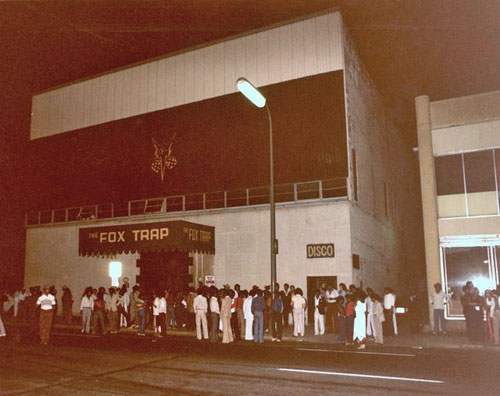
@1980 photo courtesy Minnesota Historical Society
Fox Trap Disc Jockey Found Shot to Death
On June 24, 1980, Kyle Steven Ray, age 23, was found shot to death in the vacant first floor apartment of the duplex where he lived. He was a disc jockey for the Fox Trap and on KMOJ-FM radio. The suspect was a workman who had been remodeling the downstairs apartment. Ray had planned to move out of the apartment the following day. He was scheduled to graduate that summer from the University of Minnesota with a degree in communications. A benefit was held on June 25 for Ray’s family at the Fox Trap. Although a suspect was named in the paper, no followup was found.
Fox Trap closed in late 1980.
WELLS FARGO SALOON AND WAY STATION:
Wells Fargo Saloon opened in November 1980. The owner was Ernest Pesis, and the Manager was Pete Rhodes.
The first floor was converted to a steakhouse, the second was devoted to live music.
For the third floor, Pesis imported a mechanical bull from a company called El Toro of Correles, New Mexico. It bucked at nine different speeds, clockwise or counterclockwise as controlled by an operator. It cost $7,000 used, as opposed to $9,000 new. The bull was one of four in the Twin Cities and 400 in the U.S. It cost $2 to ride (and a waiver). There was a multi-page spread of photos by Mike Zerby in the Minneapolis Tribune‘s Sunday Picture Magazine, November 30, 1980.
Despite all this fun, Wells Fargo closed in April 1981.
TASTE SHOW LOUNGE
Taste opened in May 1981. Its manager was Pete Rhodes.
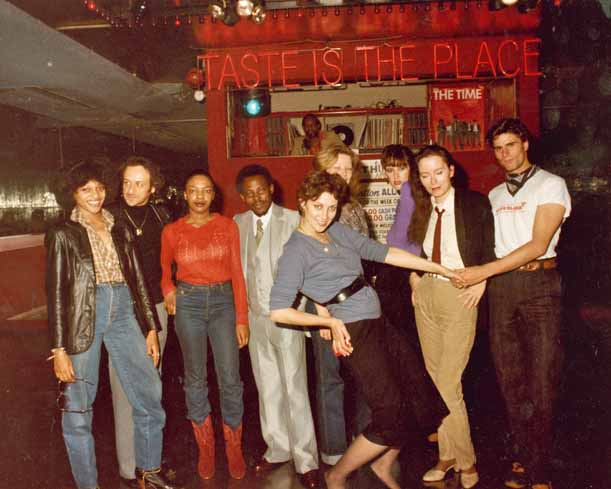
Photo by Charles Chamblis, courtesy Minnesota Historical Society
The building had three floors. The first featured live bands.
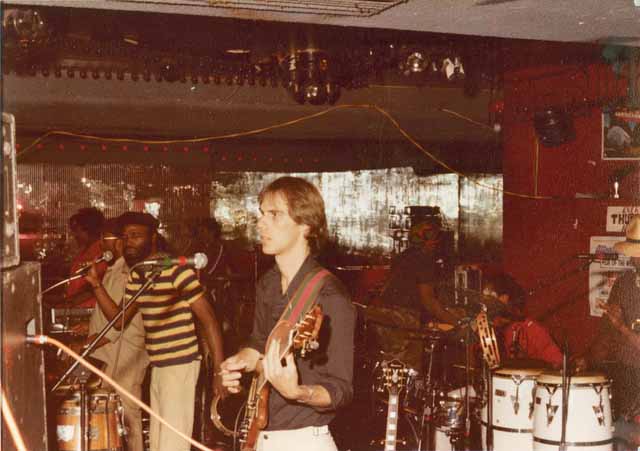
Photo by Charles Chamblis, courtesy Minnesota Historical Society
The second floor featured a disc jockey.
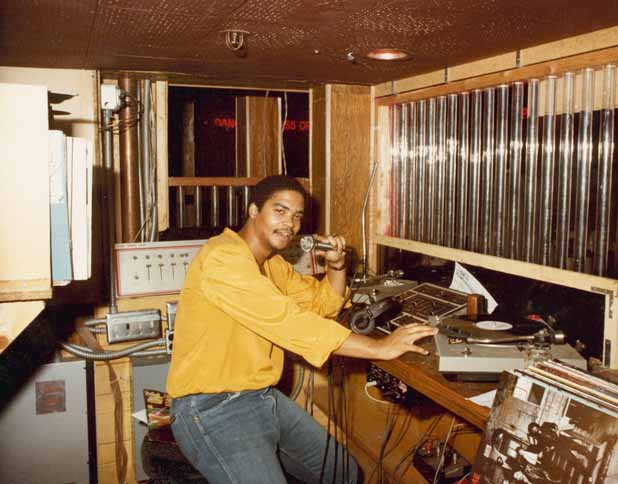
Photo by Charles Chamblis, courtesy Minnesota Historical Society
Alan Freed says that the third floor was another dance floor with a different DJ, and was not always open.
More from Alan:
The Taste was portrayed in Purple Rain, outside and inside, but was not this place, although the real Taste/Fox Trap was an inspiration. The Taste interior scenes with Apollonia 6 were shot at the Union Bar in NE Minneapolis and the exterior, I believe, was shot in LA, where a few other shots were filmed, including the Hotel Huntington exterior.
Richard says,
Taste had a second floor dance floor and the room was lined in stainless steel so that the lights from the dance floor reflected everywhere. They also had a HUGE neon sign that would flash that had a phrase of “Dance Your Ass Off,” also later available as T-shirts.. (I know.. I owned one).
Before coming over to the Gay Nineties to be a manager, Michael Bloom used to be manager/accountant at Taste for a while. He occasionally would tell me stories, and my favorite one was about two bouncer/doormen guys he would continually have to remind to get to work. Seems they were always talking music and not paying attention to the patrons. He claims the two guys were Jimmy Jam… and Terry Lewis !
In 1981 they had a “Fox of the Week” contest.
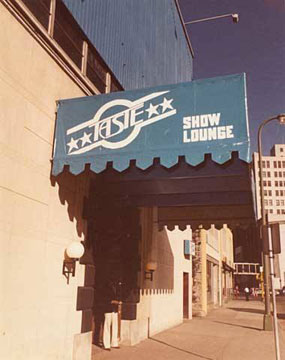
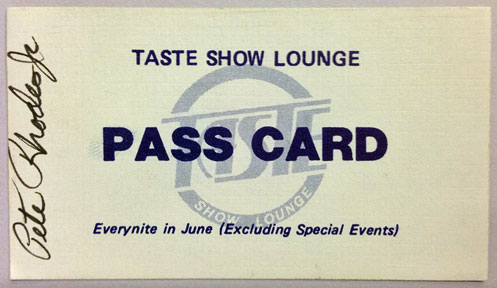
1981 Pass courtesy Alan Freed
In June 1984, Pete Rhodes noted that Taste had switched over to primarily recorded music in the past year, which had an impact on the Black Music Awards, since there were fewer black working musicians. (Minneapolis Tribune, June 8, 1984)
JUKE BOX SATURDAY NIGHT
Juke Box Saturday Night opened in November 1984 and was owned by Steve Schussler and his partners. (Pesis still owned the building.) It had a Golden Oldies theme and was the site of many benefits and also boxing matches.
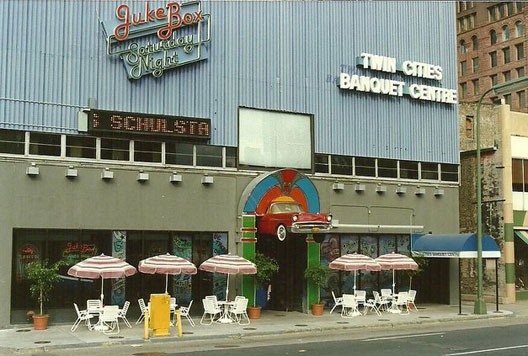
In July 1991, Schussler filed for Chapter 11 Bankruptcy, with plans to change the format. But as a stopgap measure to recoup money for his investors, he put in nude dancing in the Second Floor banquet center, incurring the wrath of the community. That space eventually became Dream Girls, run by porn purveyors the Hafiz Brothers.
Jukebox Saturday Night closed on Feburary 26, 1992.
SNEAKY PETE’S
Opened in 2007; described as a wild party bar in 2010. Owned by Peter Hafiz in 2010. In April 2011, Wally the Beer Man became a celebrity bartender before and after Twins games at Sneaky Pete’s.
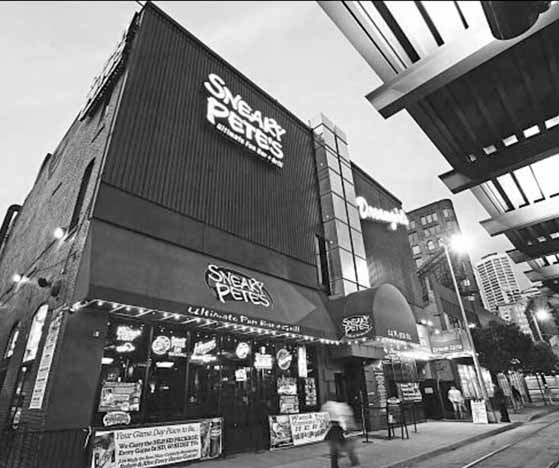
Minneapolis StarTribune, June 26, 2011
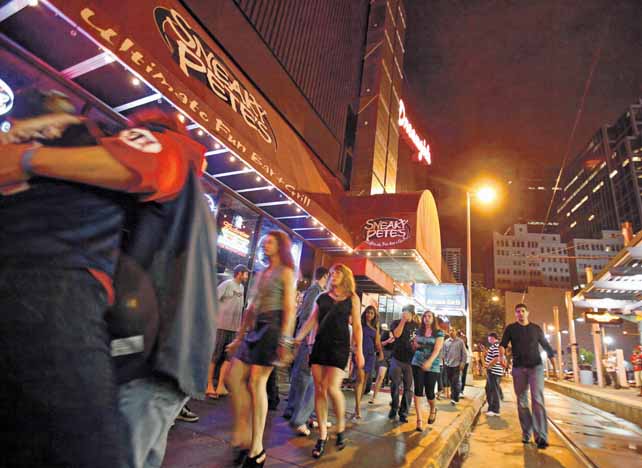
Minneapolis StarTribune, June 26, 2011
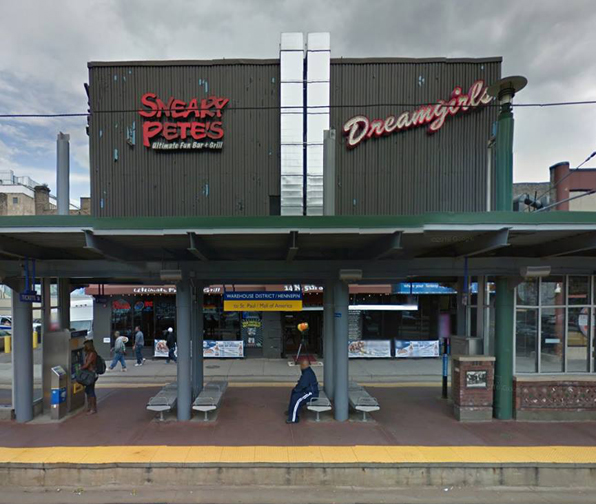
Please see the Blue Chip.
The Take Five Lounge was located at 369 Cedar Street, in the Skyway Building in Downtown St. Paul.
It was a jazz club until 1973, when Ron Maddox turned it into the Blue Chip Bar.
Please see Tafi’s
The Tea Room was at 315 First Ave. No., Minneapolis.
A 1974 Insider described it as a “Midnight to 4 am” disco that adjoins the Locker Room, a 24 hour place with steam bath, sauna, whirlpool, and private rooms.
THE TEMPO BAR AND RESTAURANT
The Tempo was located at 2027 E. Franklin Ave., Minneapolis.
EARLY HISTORY
The building appears to have been built as a store. In October 1935, the store fixtures were put up for sale.
Owner Ray Eckberg spent $6,000 to add a story and alter the building to a “beer parlor” in 1937.
The first ad for the Tempo shows up on January 1, 1939, in the Minneapolis papers.
GUS NELSON
From 1948 to 1950 it is advertised as Nelson’s Tempo Bar. Nelson was John “Gus” Nelson.
TOMMY ANDERSON
In 1952 the liquor license was transferred from Vincent F. Danzer and David S. Anderson to Danzer and Thomas J. Anderson. (Minneapolis Tribune, February 9, 1952) “Tommy” Anderson would own the Tempo until 1962.
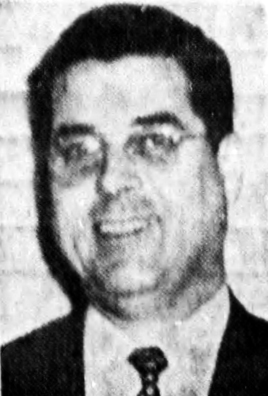
Tommy Anderson, Minneapolis Tribune, January 7, 1955
Would have loved to see the Congo Room!
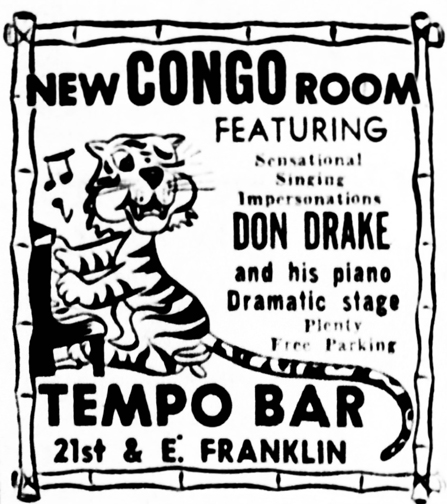
Minneapolis Star, November 13, 1953
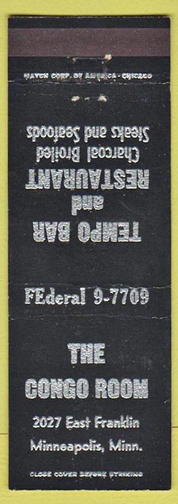
Image courtesy Mark Perrone
There was always a dog sitting in the doorway at the Tempo, simply referred to as ”The Tempo Dog.”
Here’s something you don’t see every day: a hosiery mending kit:
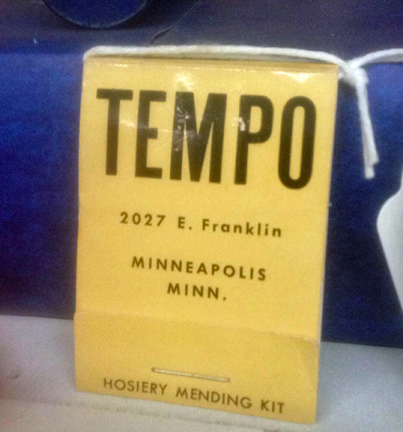
From the collection of Mark Youngblood
ADDITIONS
In November 1958, Anderson remodeled the bar, installed a new lobby, and enlarged the parking lot to accommodate 150 cars.
In June 1959, a 5,000 sq. ft. addition was being built to house a new kitchen and three private dining rooms on the first floor, and a butcher shop, laundry, bakery, and 200-seat banquet room in the basement. A coffee shop was moved into the addition. The exterior was redone in cut gray Bedford stone and plaster. J.V. Vanderbilt was the architect, and Boe, Inc. was the contractor. (Minneapolis Tribune, June 22, 1959)
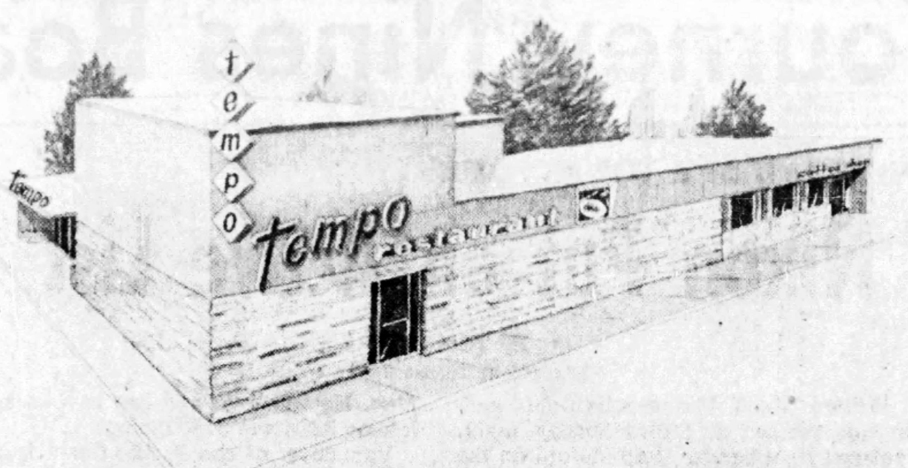
Minneapolis Tribune, June 22, 1959 (architect’s sketch)
1959 – 1963: Organ and piano bar.
Fraser and Nevers were the musical comedy duo that played there from about 1966 to 1970.
1969: Judy Richmond and her Trio; also Carla Elliott Trio featuring Judy Perkins.
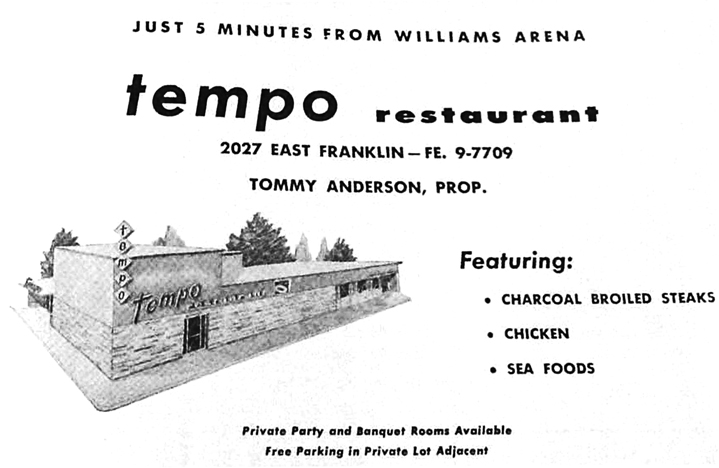
Ad from Minnesota Daily courtesy Robb Henry
21 EAST
In March 1972 it re-opened as “21 East,” with a Cantonese menu. This did not last long. But it had a great band!
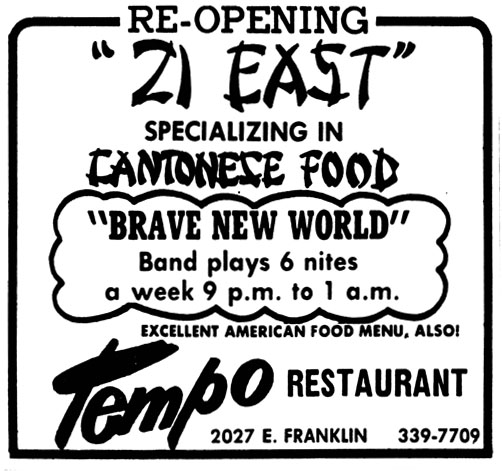
Minneapolis Star, March 2, 1979
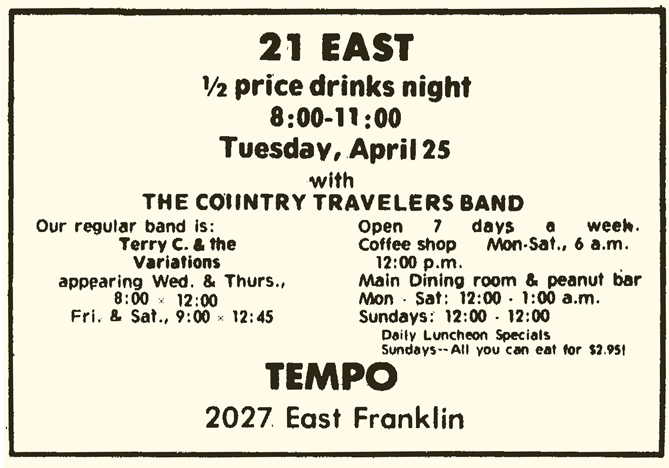
Ad courtesy Robb Henry
EARL MONTPETIT
Earl L. Montpetit purchased the Tempo in 1973. The family owned bars in Minnesota and Wisconsin, starting with Earl’s father Archie in 1909.
Ads to sell the baby grand and other accoutrements of the old Tempo began to appear in May 1973.
Started featuring rock in August 1973.
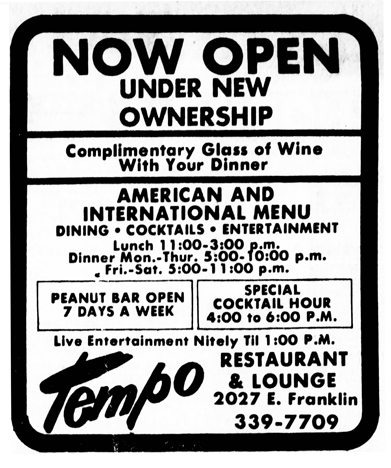
Minneapolis Star, August 10, 1973
Muddy Waters performed here, the first time not at a so-called “black club.”
There were two distinct venues at one time: one was a disco frequented by a predominantly black clientele, while the other was a rock ‘n’ roll biker bar. Must have been interesting!
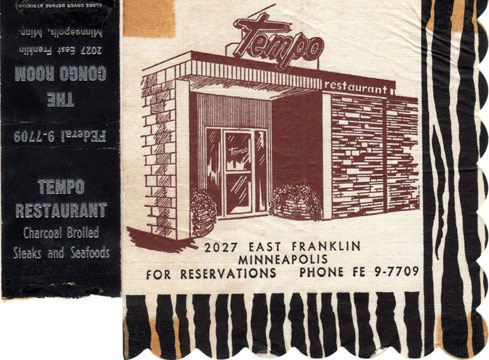
Photo above posted to Old Minneapolis Facebook page by Ken Ring.
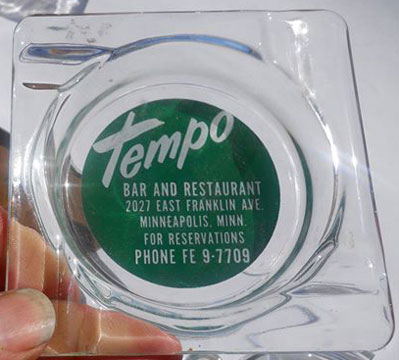
Ashtray from the collection of Mark Youngblood.
West Bank Trackers poster probably 1974 according to days of the week – Posted on Facebook by Paul Pash.
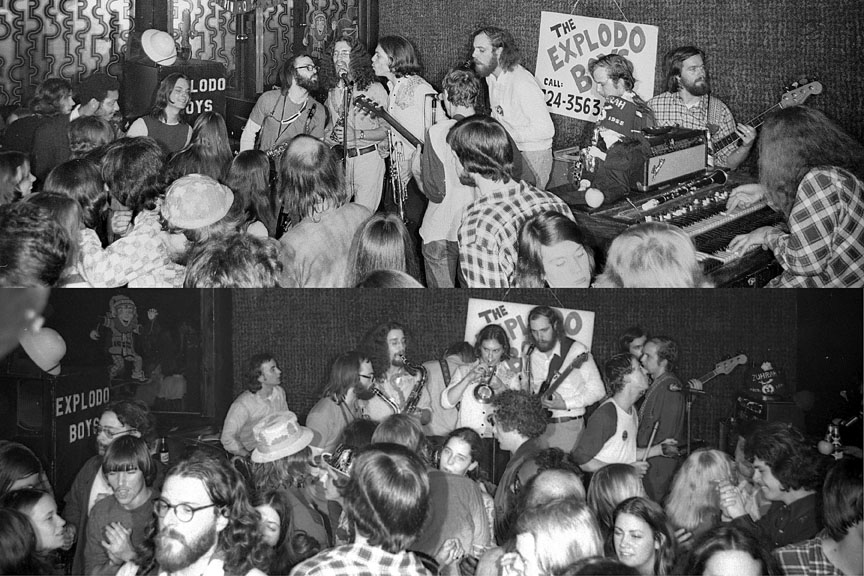
Explodo Boys at the Tempo, March 17, 1975. Photo courtesy Stephen Cowdery
The Tempo closed on Labor Day, 1979.
MONTANITA’S
Montpetit transformed the Tempo into a Mexican restaurant called Montanita’s – Spanish for the French name Montpetit – in January 1980. A Spanish guitar player accompanied patrons at the restaurant, which seated 240.
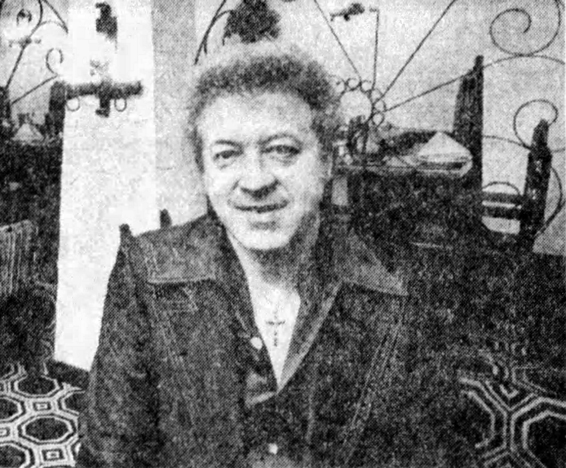
Earl Montpetit. Photo by John Croft, Minneapolis Tribune, February 23, 1980
Montpetit tried to build one in the World Trade Center in downtown St. Paul, but it went bankrupt. There was also one in Spring Lake Park.
Earl Montpetit sold Montanita’s on Franklin in January 1990. He died on January 8, 1992, at the age of 64 of liver cancer.
Montanita’s on Franklin closed sometime between September 1994 and February 1995.
BLUE NILE
The Blue Nile was an Ethiopian restaurant that moved into the building from its former location on Lyndale in January 1997. One of the musical performers there was the Electric Arab Orchestra. The Blue Nile closed on November 15, 2015.
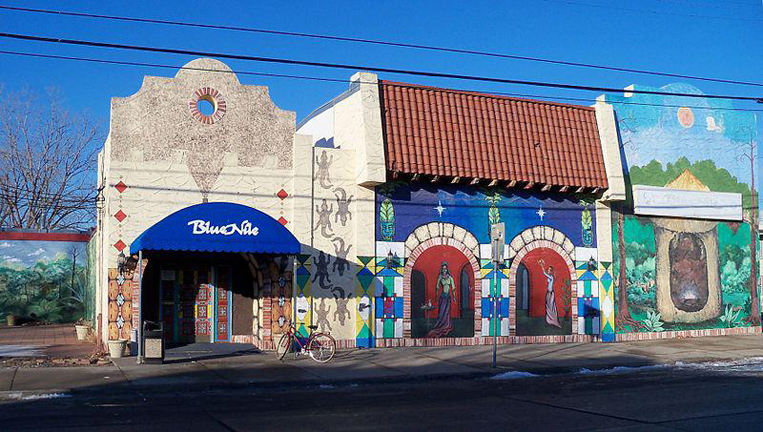
The building has been torn down. In 2020 the property is shown as vacant land owned by the Indian Health Board of Minneapolis.
Save
St. Paul – jazz venue
This building had been built at 219-223 Marquette Ave.
CURTIS BUILDING
According to Randolph Edgar’s history written in 1928, the stones for the foundation of this building were supposed to have been picked up from the Mississippi River bed. A store occupied the ground floor, offices were on the second floor, and the third floor was a hall. The hall was used as a business college, and during the period when Central High School was being built the students went to school here as well
Next, George Scott made the third floor into a small theater for three month, floowed a dog show.
In 1877 Chambers Brothers reopened the theater.
THEATRE COMIQUE
Captain W.W. Brown, who had been managing the Standard Theater, moved the variety shows to the Theater Comique from August 1881 to March 1897, entertaining mostly lumberjacks, according to Randolph Edgar. Brown rebuilt the theater several times, enlarging the the stage, increasing the seating capacity, and finally doing away with the third floor and replaced it with a balcony. After making a fortune from the theater and losing it by other investments, Brown let the Comique became a rat-infested dive with secret stairways, wine rooms, and subcellars.
SALVATION ARMY
In 1895 the building was taken over by the Salvation Army.
The building burned to the ground on July 23, 1901.
There were two locations for Thumper’s.
THUMPER’S SOUTH
The original Thumper’s started out at Schlief’s Little City, a polka dance hall in Inver Grove Heights and South Robert Street (7884 Courthouse Blvd.)
Thumper’s South opened on December 14, 1978.
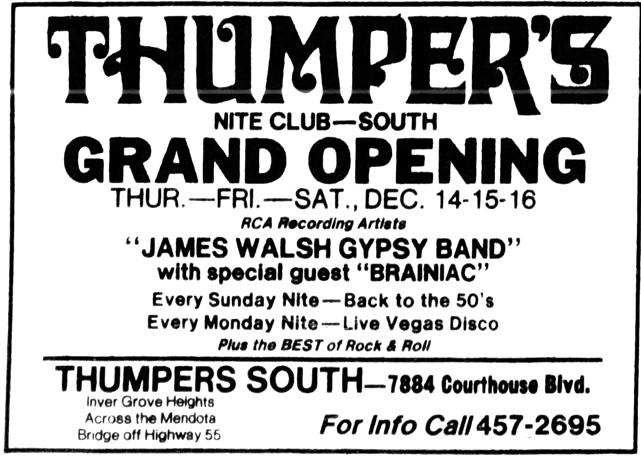
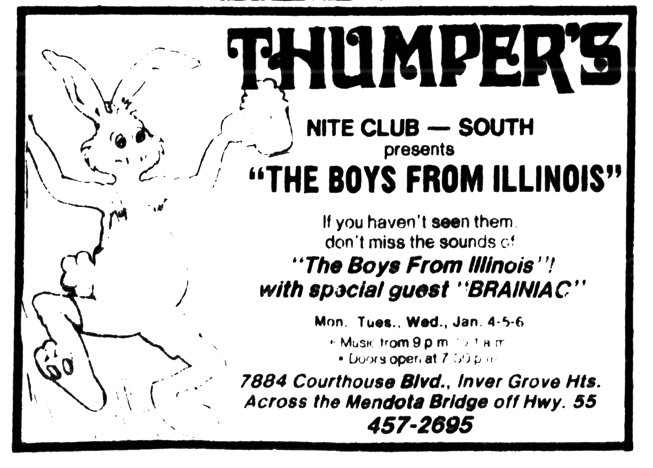
This is apparently Thumper.
Thumper’s South was owned by Mickey Sazenski and managed by Dennis Sazenski. The actual ownership was in question, so Mickey let the insurance lapse in March 1979 and hoped to reopen in June. Unclear whether it did.
Thumper’s South became Peabody’s in November 1979.
THUMPER’S NORTH
There was another Thumper’s at 2020 Northdale Blvd. in Coon Rapids, owned by Mickey Sazenski.
David Allan Wright has posted a video of the local band Chameleon at a performance at Thumper’s North on July 15, 1978.
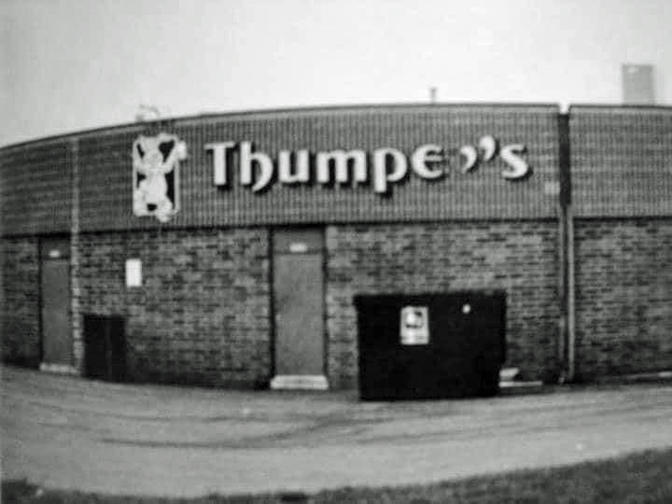
Thumper’s North – photo courtesy Laurie Peterson Buck
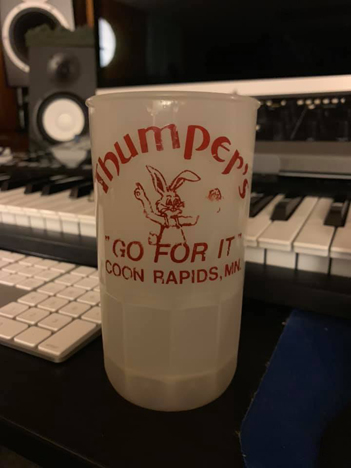
Chip Barber’s Thumper’s North Mug!
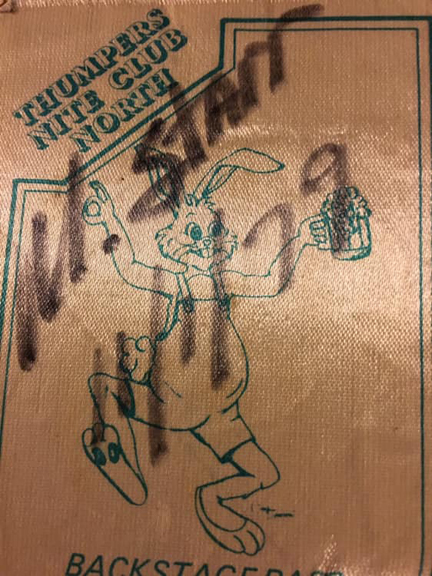
Thumper’s North Pass posted by Sandra Kenyon
Thumper’s North later became La Fiesta in 1985. I only found one reference in the Minneapolis papers in January 1986.
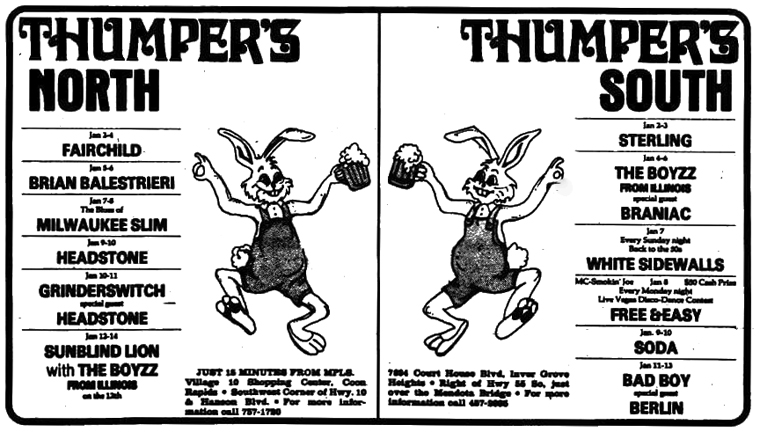
Thumper’s Schedules, January 1979 – courtesy Kim Brandell
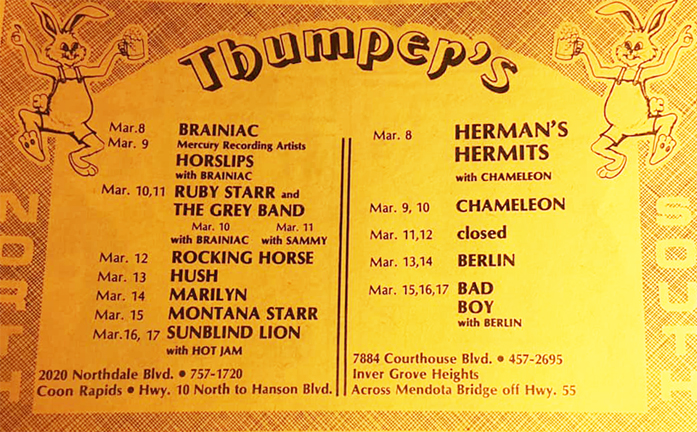
Thumper’s North and South Schedules, March 1979, courtesy Sandra Kenyon
The Thunderbird Motel was located at 2201 E. 78th St. in Bloomington, on the 494 strip. It was built in 1962 and had 255 rooms.
Perfectly placed to take advantage of the new highway and the new Met Stadium nearby, the motel was the baby of Rodney S. Wallace. Wallace’s obituary, at the bottom of this page, tells the story of his love of his motel.
Wallace had originally planned to build the complex at the Northwest corner of 494 and Cedar Ave. in Richfield. The motel was one of 39 Thunderbird motels across the country, including the one in Las Vegas, according to the Minneapolis Tribune (August 18, 1962).
Ground was broken on November 19, 1962, with delays related to the installation of utilities. (Minneapolis Star, November 20, 1962). The building was designed by S.C. Smiley and Associates of Minneapolis, and constructed by Kraus Anderson.
The building went up in phases. Many phases. The ones that came to pass are marked with an asterisk.
- *The first phase opened for business on May 20, 1963, with 108 units, a restaurant that seated 200, a lounge that seated 55, and convention facilities that could seat up to 780. An adjoining gas station was part of the property. The cost of Phase I was $2.5 million. (Minneapolis Star, May 17 and June 27, 1963)
- Phase II-A was originally planned to have an additional 140 rooms at a cost of $2 million.
- Phase II-B scaled the expansion down to 80 rooms for $1.25 million because 140 more rooms would have taxed food and beverage facilities. Instead of the additional rooms, it planned to build a piano bar, an indoor swimming pool, and additional kitchen facilities and meeting rooms. (Tribune, September 19, 1963)
- *Phase II-C changed the expansion plan yet again, with only 48 more rooms added. A new barber shop, beauty salon, and renovation of the banquet hall brought in an estimate of $500,000. Work began on that phase sometime between August and November 1964. This would have brought the total to 156.
- Phase III was ambitious. For 3.5 million, the motel would get: (Tribune, August 11, 1964)
-
- An expansion of the parking lot to hold 1,000 cars;
- A cocktail lounge called the Cliff Dwellers that would hold 150 people;
- A 75-ft. expansion of the main building;
- A suspended, glass-enclosed walkway connecting the main building to the motel section;
- A three-story addition that would include
-
- 150 more rooms
- An indoor pool
- Sports facilities
- Exhibit hall
- Small Shops
-
-
- Phase IV: This plan for a 10-story, $2 million addition would add 135 to the present total of 175. (Somehow I’m missing 19 rooms.) The tower would have a cocktail lounge and shops, and would be west of the motel. Wallace didn’t rule out yet another 10-story tower in the future. (Tribune August 26, 1965)
- *Phase V-A: This was a circular, 50-room addition to the west end, with two indoor swimming pools, to cost $750,000. This apparently got done; an ad in April 1968 said that the indoor pool complex was now open. And a report in October 1968 said that the newly-expanded motel had 200 rooms. If the 255 number from Wikipedia is right, he actually added 99 rooms in 1968. I’ve totally lost count.
- *Phase V-B: That 10-story, 150-room tower from Phase IV, at a cost of $2,250,000. Wallace said that Phase IV didn’t progress because of financing problems and indecision among the other 19 owners of the corporation, so he had bought out the other stockholders in July 1966. (Tribune November 2, 1967)
- Little Bitty Phase? In August 1973, six additional units were approved by the Bloomington City Council. (Minneapolis Star, August 23, 1973)
2051 Ford Parkway, St. Paul. Purchased by the Montpetit family in 1971. Doubled in size in 1973, restaurant added in 1982. Became a Packers Sports Bar in 1986. In 1998 it became the HQ for the Kansas Jayhawks. In 2016 owned by Blake Montpetit.
The Tivoli Beer Gardens and Concert Hall was located at the entrance to the Wabasha Bridge in St. Paul.
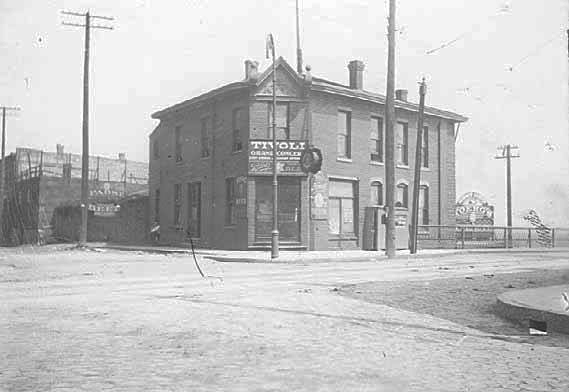
Tivoli in 1900, Courtesy Minnesota Historical Society
In the photo below, Russ Hanson colorized the MHS photo above and overlaid it onto a Google Earth view at the original site viewed at the 2018 modern day location. Photo from Facebook.
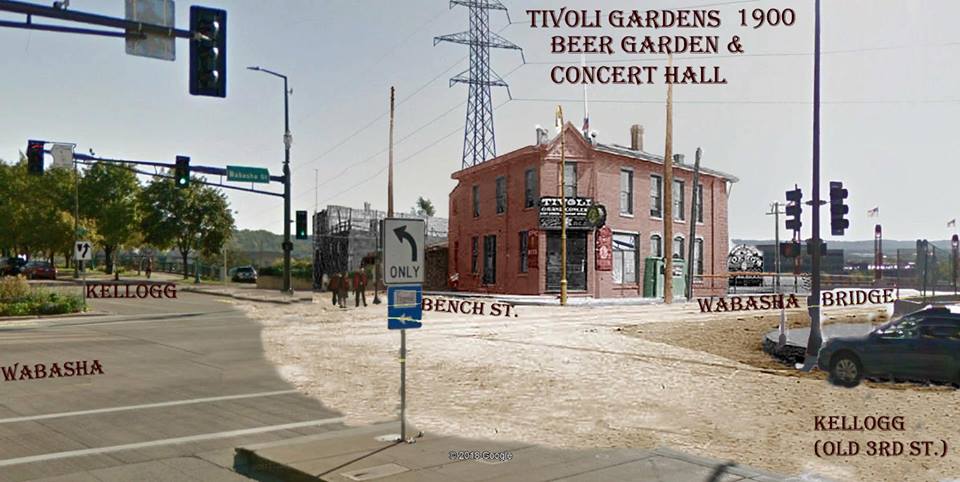
The Beer Garden was located on a balcony overlooking the Mississippi River. Here are two views, posted by Russ Hanson:
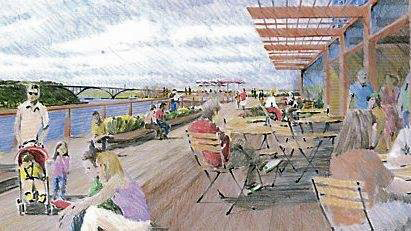
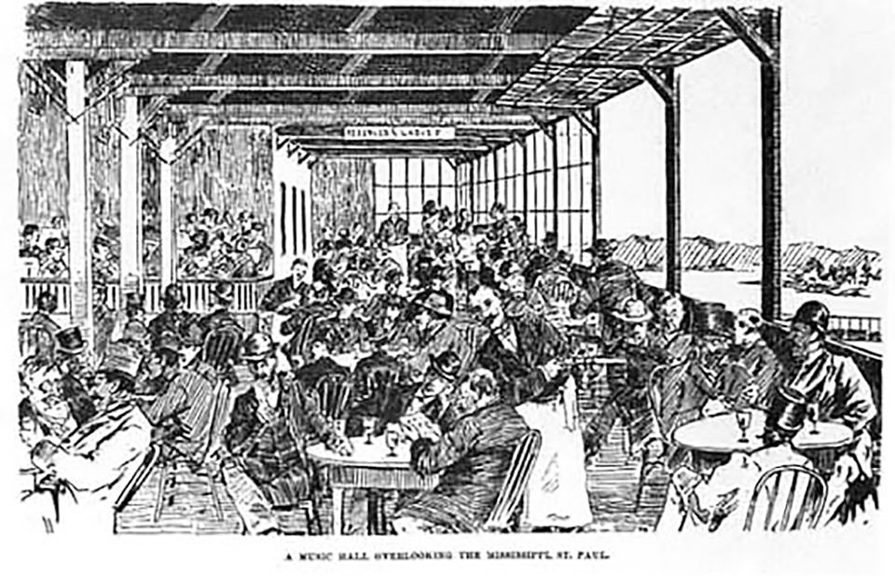
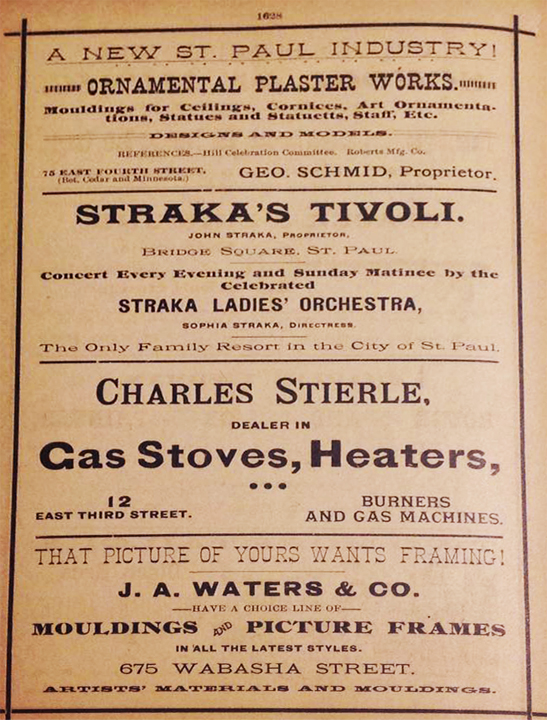
1893 St. Paul Directory page, posted by Mark Youngblood
THE STRAKA FAMILY
Fortunately, David Straka saw the post and provides this information:
I am thrilled to see this post! I believe this business was also known (perhaps informally) as Straka’s Tivoli, and the proprietor was my great-grandfather John Straka. Earlier in his life, he was leader of his own world-traveling “family orchestra,”and after he settled in St. Paul and established The Tivoli, his daughters were employed as regular performers there. It’s a thrill to see this photo for the first time. As far as I know, nobody in my family has one.
David kindly posted the program below, dated February 6, 1899. The Tivoli was owned by John Straka, David’s Great Grandfather. David says that the Straka Ladies Orchestra listed in the top right-hand corner of the program included two of his great aunts.
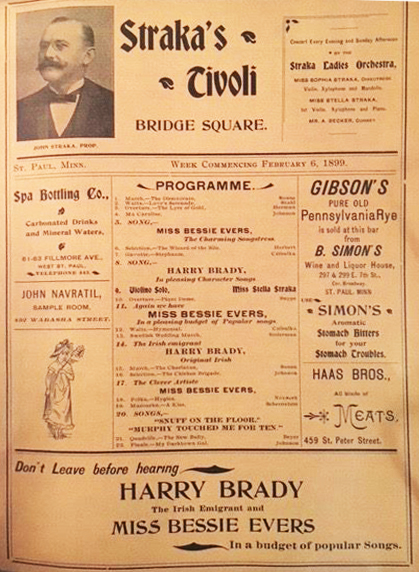
THE END OF THE TIVOLI
Russ notes that in the Great Cyclone of August 20, 1904, with winds gusting to 180 mph, hit this corner and killed three people and injured fifty others. Most of these victims were either in the Tivoli or the Empire across the street when it hit. David Straka confirms that according to in-family oral history, the building was destroyed in the 1904 tornado, ending the business.
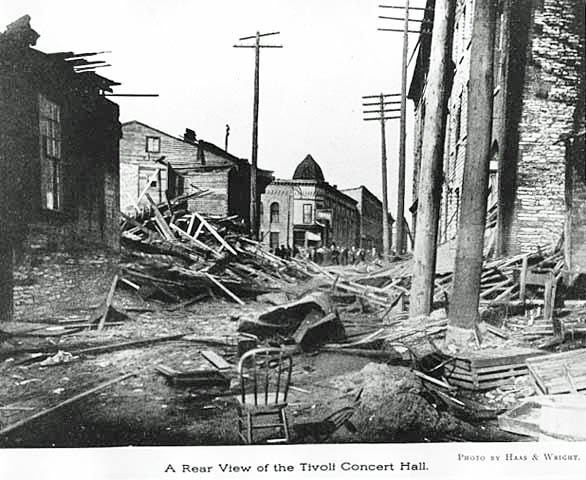
Aftermath of the 1904 Cyclone; Minnesota Historical Society
The Tom Tom Room/Lounge was at the Minnehaha Lanes Bowling Alley, 955 Seminary Ave., St. Paul. Minnehaha Lanes was founded in 1958 by William Manion, a St. Paul bowling advocate who died in 1997.
In 1969 it was a regular showcase of the Mystics, six of seven members of which lived in St. Paul.
According to the ad below, it attracted all the best bands to perform.
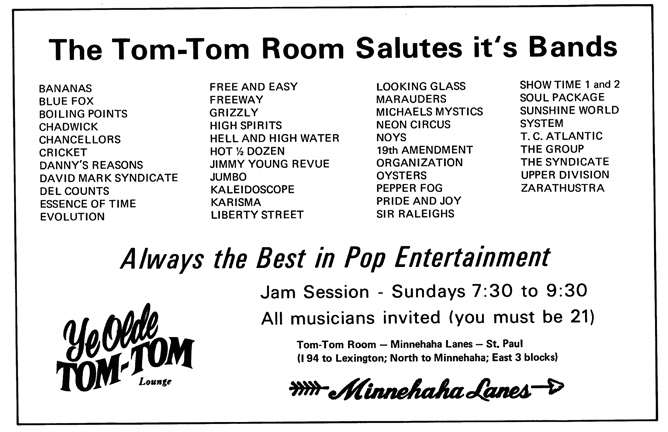
Insider, October 10, 1970
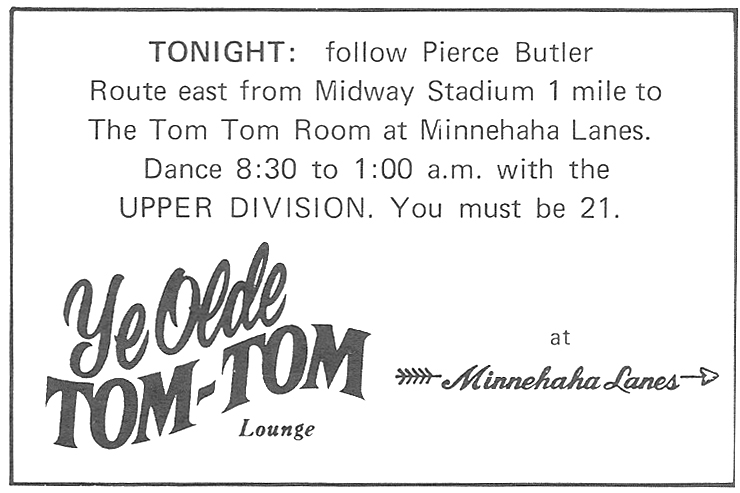
Insider, June-July 1971
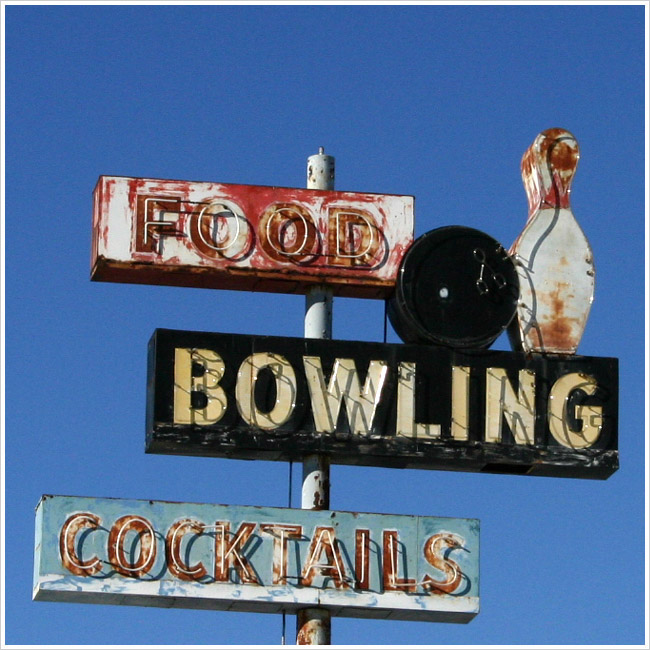
Photo by Kevin Dunne, 2005, via Flickr
In 2008 the aging facility was purchased by the St. Paul Port Authority. The demise of the Lanes was ascribed to the smoking ban, which took place a year before the statewide ban, and a failed previous purchase that made leagues wary of signing up.
Was there another Tom Tom Room at 528 So. Concord, in St. Paul, 1969-74?
Toni’s M & M Supper Club was located at 356 Monroe Street NE in Minneapolis.
THE BUILDING
Structures of one kind or another (ice house, smoke house, etc.) have been on this property going back to at least 1885. The first match in the newspapers database is a John Muskola, who sold “Cold Dogs” at his grocery store and candy shop in 1922. The place was for sale in 1924 and again in 1940, advertised as suitable for one or two stores to sell liquor.
There were two stores – one was a cafe called the Chili Bowl in 1946, and remaining a cafe until at least 1957.
The other half was a variety store, which sold its stock.
Then, the permit cards indicate that the old building – a 30 x 40 x 16, 1.5 story commercial building – was demolished in November 1970.
NEW BUILDING
The same month the demolition permit was issued, a building permit was issued for the new building. This was a 50 x 90 x 10, 1 story restaurant and bar.
The new business would have the complicated name Toni’s M & M Supper Club, named after the owners Toni Mlekoday, and John and Jerry Mlekoday. The ad below is one of only a few published when the business started.
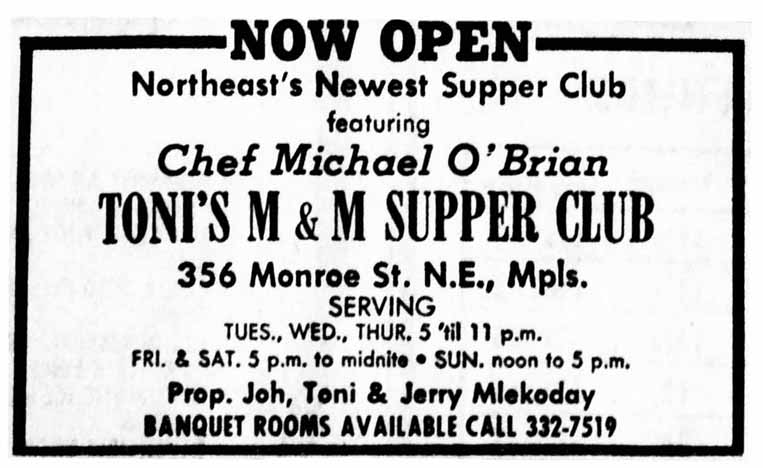
Minneapolis Tribune, June 19, 1971
There’s not much to know about the Supper Club – apparently nobody tried to rob it, except for once in 1974 when the Minneapolis Star called it a Night Club. That would indicate that there might have been live music.
There was definitely live music in April 1981, when the Bees Knees showed up in a calendar of events.
In September 1982, John Mlekoday sold the business to Toni’s M & M Supper Club, Inc. for $1,000. That would help date the artifact found by Wendy Richardson as after that year.
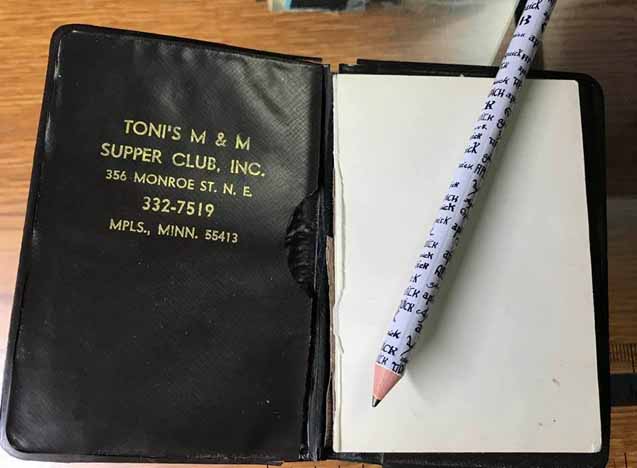
Image posted on Facebook by Wendy Richardson
OTHER VENUES
There were apparently other venues inside the building:
Bartylla’s shows up in December 1983, presenting music.
Phnom Penh, a Cambodian restaurant, appeared in September 1985, and food reviewer Jeremy Iggers suggested that a Cambodian musical group would be a welcome addition.
IT’S A RAID!
Toni’s (at this point often called Tony’s) was raided by the police on February 10, 1988, and had its video poker machines confiscated. The problem was not that it was illegal to play video poker. The problem was that it was illegal to take money instead of additional games when you won, and at Toni’s, the bartender was caught giving money to winners. (Minneapolis Tribune, February 11, 1988)
OTHER VENUES, PART 2
Continuing with our search under the address, we find:
Mr. Gibbs M & M Supper Club (March 11, 1990)
Tony, Mouse, and McGillicuddy’s (July 10, 1993)
MOOSE ON MONROE
The building became the home of Moose on Monroe as of about June 1997. The sign on the picture on Google Maps says Moose Bar and Grill.
1001 Central Ave. NE. Polka by a group by the Red Ravens, reported Will Jones in May 1963, with much dancing. Proprietor was Tony Ferraro.
TORCH CLUB
This venue, alternately called the Torch Club, Torch Tavern, or Torch Bar, was located at 607 W. Lake Street at Lyndale. Not to be confused with the men’s business club that was formed in 1924, or a credit card used from 1969 to 1982. (!)
The Torch Bar goes back to at least December 1941, when it was owned by William Anderson. At that time it was the Torch Cafe.
It was sold in January 1945.
In September 1946 it reopened as the Torch Bar.
At one point it was a Country bar and acts were broadcast over KEVE.
1954: “Over 21 and Like to Dance? Orchestra music 9-1 nightly.”
In January 1960, the booths and cigarette machines were listed for sale.
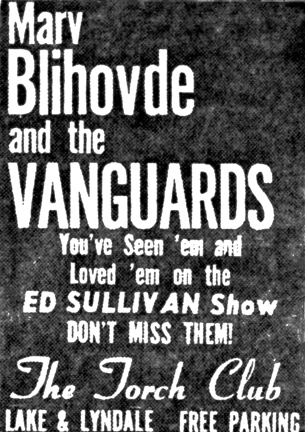
Minneapolis Star, September 24, 1960
On November 26, 1960, National Act Gene Vincent and the Blue Caps were advertised.
POKER BEER
The ad below is undated, but from the music, my guess is 1962.
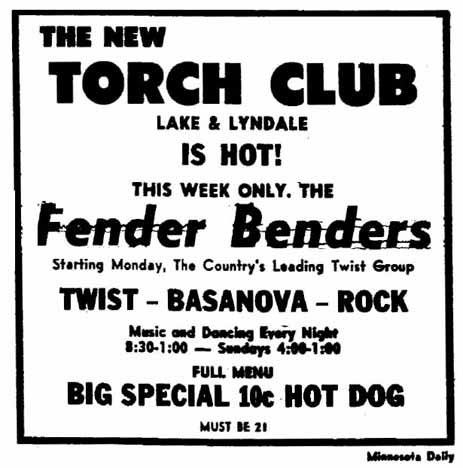
Minnesota Daily. Ad courtesy Robb Henry
During one engagement at the Torch, Sherwin Linton was puzzled to observe that the audience was twice as drunk as at other 3.2 bars. When he asked the bartender, he was told that it was because they were drinking “poker beer.” This was a process where the bartender stuck a hot poker in a pitcher of beer for a couple of seconds – long enough to take about half the carbonation out of it. This allowed the customer to drink it faster, and thus get a lot drunker. Poker Beer.
Another time, Sherwin was playing at the Torch, and wrestler Verne Gagne came in. Sherwin didn’t recognize him at first, but the other customers were delighted to see him. They encouraged him to get up and sing a couple of songs, which he did, badly. But his public adored him, and gave him quite an ovation. I forgot to write down which songs he sang.
In 1963 the Aztecs played music to accompany the Lindy, the Bunny Hop, the Twist, and the Limbo.
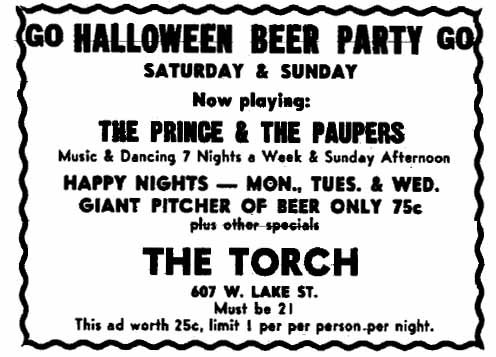
Minnesota Daily. Ad courtesy Robb Henry
One wag on Facebook remembered: “Best Hamburgers were at Danny’s Den on 31st and Lyndale. Draft beer 15 cents. Then you could go over to the Torch bar thru the alley and get beat up. Middle 60’s.”
On Facebook we learn that the owners were Carl and Bonnie Scherber. They later left to own a bar in Las Vegas.
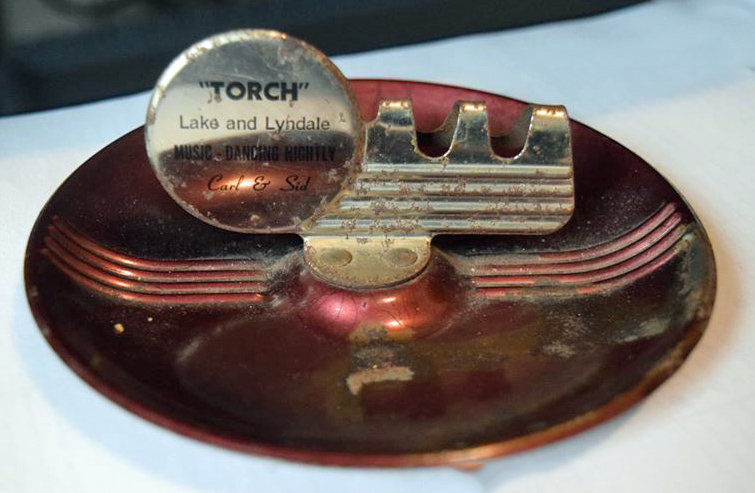
Image courtesy Donnie Edson
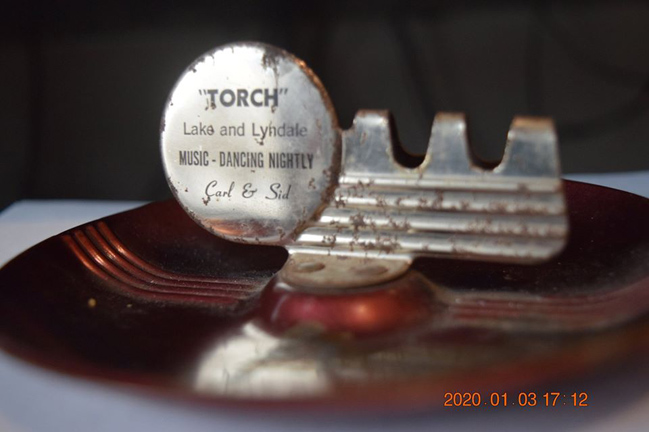
Image Courtesy Donnie Edson
On March 6, 1966, a fire caused $20,000 damage, destroying the interior of the Torch. Flames burned through the false ceiling but did not burn through the roof of the one-story building. (Minneapolis Tribune, March 6, 1966)
The operator was Sidney Haskovitz. An article dated March 9, 1966, said that once the bar was ready to be reopened, which was expected to take 60 days, it would be closed for 15 days because of a violation where a minor was able to drink beer.
DULONO’S PIZZA
By March 13, 1966, the building was suddenly Dulono’s Pizza Shack, which was apparently moved here from 1401 W. Lake Street.
In 1969 the Wayfarers performed here.
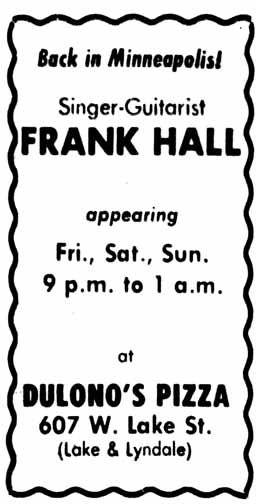
Minneapolis Star, June 22, 1972
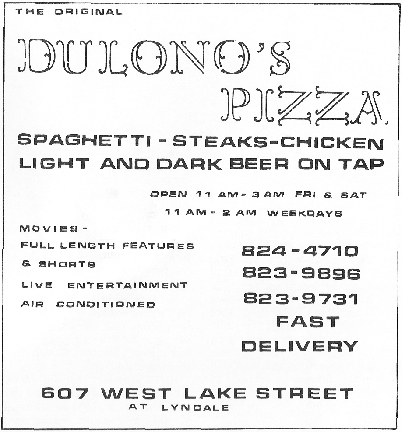
Waterfall Magazine, July 1972
The Town House was in Rogers – open to teens on Fridays in 1967.
The Town House Restaurant was located at 1415 University Ave., St. Paul.
This building was built in 1924 and is still there. Chat on Facebook reveals that Russian-born architect Werner Wittkamp remodeled the building in the 1940s.
The photos below, from the St. Paul Pioneer Press, are from 1952.
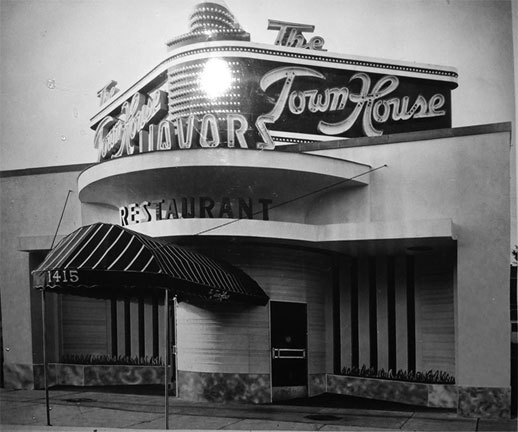
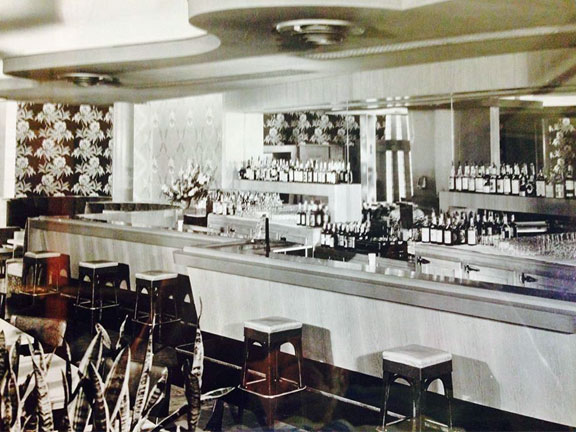
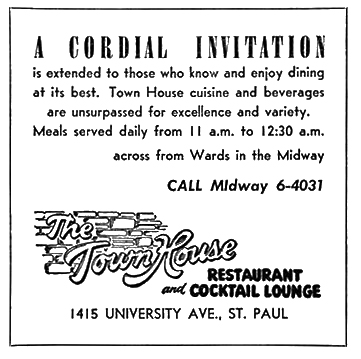
1958
At one time it was owned by Pat and Veronica McLean and managed by son Bob.
Clark Armstead (of Clark’s Submarines) owned it from the early 1960s to 1968.
In an article about R&B, Allan Holbert mentioned the Town House as a venue to hear it, along with King Solomon’s Mines and the Cozy Bar. (Minneapolis Tribune, December 3, 1967)
Emmet Jewel bought it in 1968 and sold it in 1985, just before he passed away.
Holly Monnett managed it for many years and bought it from Jewell in 1985. It has been a gay bar for years.

Monnett sold it to Wes Burdine, and in August 2018 Burdine opened it as the Black Hart.
Save
Trabert’s Place was located at 1209 West 7th Street in St. Paul. See Stransky’s.
This page will cover the music venues located at 1601 University Ave. West in St. Paul.
Much of this information comes from lyfmap.com and the Turf Club’s website.
HOVE FOOD MARKET
According to Ramsey County, the building was built in 1922 as a grocery store. It was a one-story brick structure with a steel ceiling.
KIRCH & GILLIS
Next door to Hove’s was a pool hall named for the two owners: Kirch and P.H. Gillis. At some point after Prohibition ended in 1933, they took over the food store and converted it into a bar with the same name.
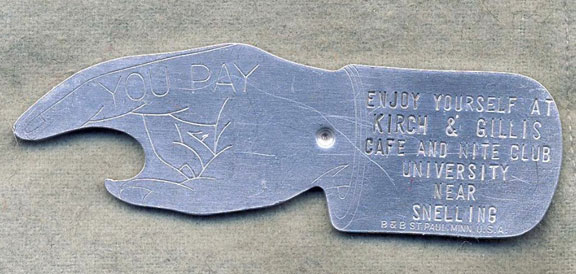
On November 6, 1942, a three-alarm fire destroyed the bar with a blast that blew out the front and rear ends of the building an hour after closing time. The cause of the explosion was unknown, although tavern manager Norman Nelson didn’t think it was of “incendiary origin.” Damage was estimated at $40,000. (Minneapolis Star, November 6, 1942)
The Turf Club website says that “a local newspaper” (probably from St. Paul) did note that the fire was difficult to extinguish because of exploding liquor bottles. No one was injured except for 79-year-old Mrs. Julia A. Kehne, who tripped over a fire hose the next day.
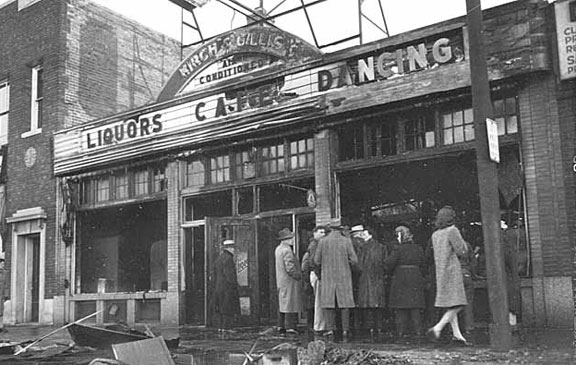
Aftermath of 1942 fire; photo courtesy Minnesota Historical Society
The ad below promises Thanksgiving dinner (at popular prices) and dancing to Lowell (Huck) Round and his band. Didn’t that look like Huck Hound to you at first?
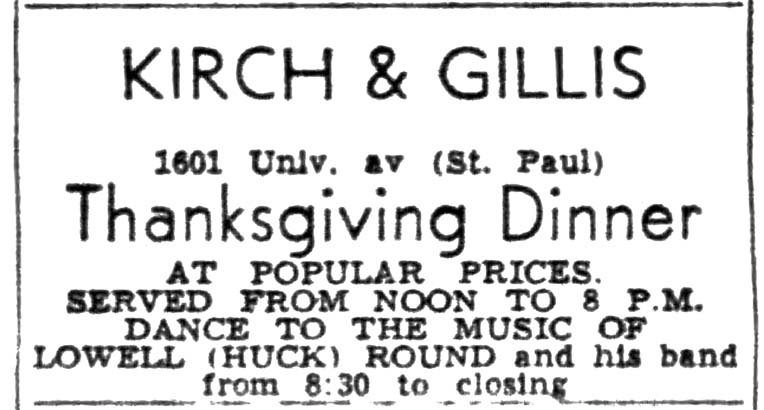
Minneapolis Star, November 26, 1947
Not exactly sure why this ad announces the Grand Opening of a bar that had been open over ten years, but it wasn’t unusual. Perhaps there was a social season. This one promises music by Shorty Brier’s Band and “stage bar antics” by Johnny Konchal.
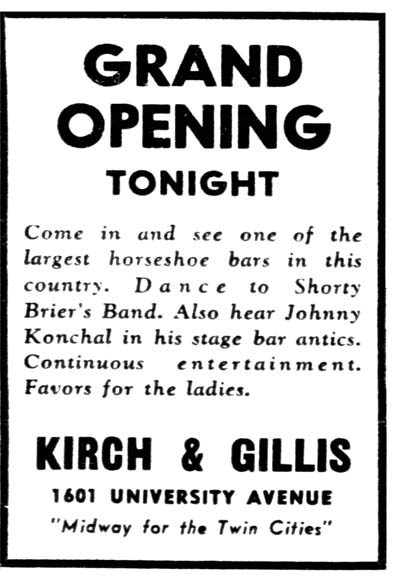
Minneapolis Star, March 23, 1949
TRADE WINDS
In 1959, the club was purchased by Jack White and renamed the Trade Winds.
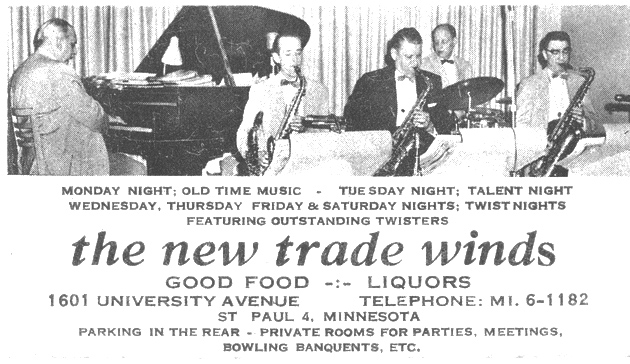
Business card courtesy Minnesota Historical Society
JACK WHITE
Jack White (John Michael Wiese II) was a self-taught musician and band leader from 1930 until 1969. During the 1940s, his orchestra regularly performed at many Twin Cities locations including Curly’s, Stranski’s Night Club, Coleman’s, the Red Feather, Prom Ballroom, and the Air-O-Inn. His weekly show was often broadcast on the radio on Sunday nights and recorded by his wife, who owned a record maker in their basement. White played at the Trade Winds almost nightly until his death in 1969.
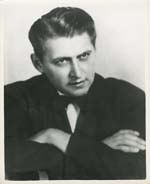
Photo of Jack White courtesy Minnesota Historical Society
ANOTHER FIRE
Fire hit the building once again on July 30, 1960. 100 patrons had to evacuate the building for the three-alarm blaze and three firemen were treated for smoke inhalation at Ancker Hospital. The fire started in the basement and ate through the floor of the one-story building. The bar fell into the basement. Damage was estimated at more than $35,000. (Minneapolis Star, July 30, 1960)
The restaurant was back on its feet in January 1961.
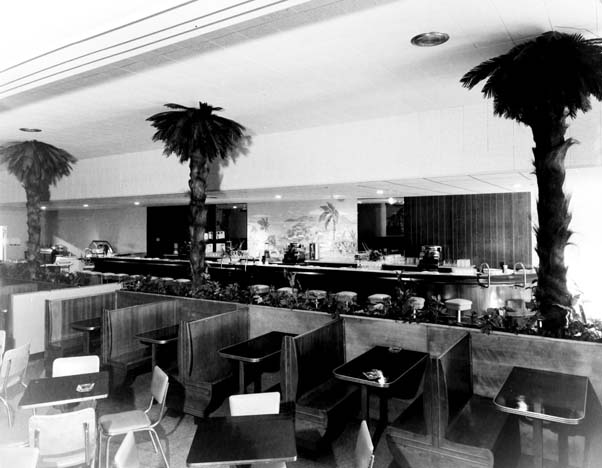
Photo courtesy Minnesota Historical Society via lyfmap.com
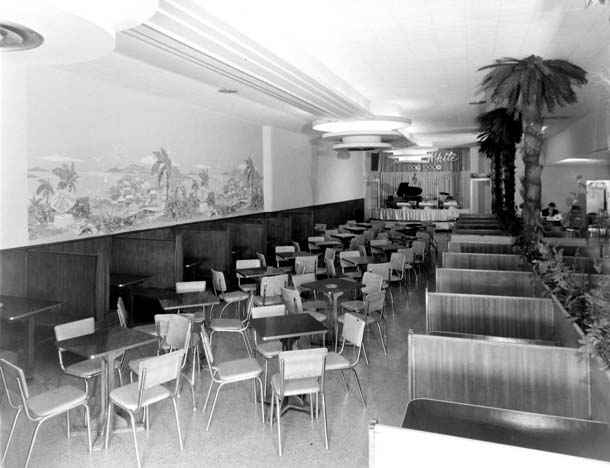
Photo courtesy Minnesota Historical Society via lyfmap.com
In March 1963, Will Jones noted that at the Trade Winds they were now playing Calypso and Limbo. (Minneapolis Tribune, March 12, 1963).
A report of a slugging of a lady counting receipts reveals that the owner of the Trade Winds was her brother, Clarence Wallraff. The lady kept screaming even after she was slugged with a gun, and the bandit got out of there leaving stacks of money behind. An alert bystander got the license plate and three rough-looking robbers were nabbed. (Minneapolis Star, April 8, 1963)
That particular holdup made the bar infamous, in that one of the men captured was connected with the T. Eugene Thompson murder. He had handled the Luger that was procured to kill Mrs. Thompson, although it wasn’t actually used in the murder.
Amateur Nights at the Trade Winds were on Tuesdays, reported Will Jones in November 1963.
By July 1964, the Trade Winds was the name of a folksinging group. And a line of campers.
TURF CLUB
At some point the Trade Winds became the Turf Club. I am taking information from multiple sources and none of them make any sense. The only thing I can count on are primary sources, and the last mention of the Trade Winds was in November 1963. The first mention of the Turf Club at this address (the bartender got shot in the leg) was on February 5, 1975. When I find out more, I’ll let you know!
P.S. There was another Turf Club in Minneapolis that became the White House.
The Triangle Bar was at 1822 Riverside on the West Bank, at the confluence of Riverside, 19th Ave. So., and 4th Street So. It’s said to be the oldest bar in Minneapolis, dating back to 1887, although Hennepin County dates the building to 1901. See a comprehensive history here. In 1941 Frank Ojilie was the proprietor and “swamper.”
It began hosting live music in 1964, with Spider John Koerner the first paid musician. Koerner, Ray, and Glover were frequent performers. In mid-1971 it got a license to host groups.
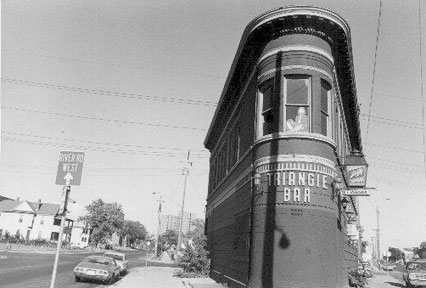
Courtesy of Hennepin County Library, Minneapolis Collection
It became the Ole Piper Inn in 1976, and closed down in about 1990. The building is now listed as residential.
Save
Please see Mr. Lucky’s.
Triviski’s Bar was located at 678 Selby Ave. in St. Paul.
The earliest evidence of a building at this site found in the Minneapolis papers was an unnamed grocery store where, in September 1927, a robber threw acid in the face of the proprietor’s daughter. He was caught and sent to Stillwater State Prison.
In April 1937 the place was a bar, but the name was unreported.
In May 1946 it was Carron’s Cafe, where liquor was served.
TRIVISKI’S BAR
The St. Paul papers would be more helpful, but unfortunately they are not online. We know from the Minneapolis papers that Lyle M. Triviski was a partner in Triviski’s Bar as of March 1953, because of a story of a robbery.
In February 1954, Lyle was arrested in a crackdown on altering whiskey, which was a Federal felony. The IRS could impose a maximum penalty of $1,000 and two years in prison. Although Lyle was indicted, no further news was reported, so either the case was dropped or he paid his fine. He was accused of altering four brands of whiskey.
Five years later, in April 1959, Lyle was in trouble again, this time for selling liquor on a Sunday to an undercover policeman. No report of the outcome.
In February 1961 an ad appeared, selling a “Deluxe Piano Bar with Grand Piano and Stools.” Music!
In August 1962, Texas Bill Strength had finished a night of entertaining at Triviski’s when he was shot in the leg at the apartment of a friend.
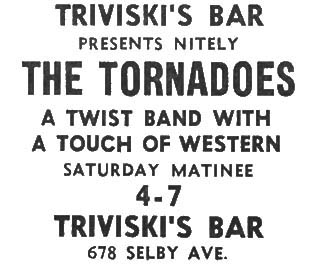
Ad courtesy Tornado Jack Doepke
Sherwin Linton tells a story about a four week stint at Triviski’s with his band, the Fender Benders, starting in March 1963. He was to play six nights a week, but after witnessing a fight with the combatants armed with chains, he had his doubts about the place, and never came back.
After an argument about a game of pool, a disgruntled young man left, returned with a gun, and killed one man and wounded his half brother. Both the murdered man and the shooter were 21 years old with no fixed address. The murder occurred on September 27, 1971.
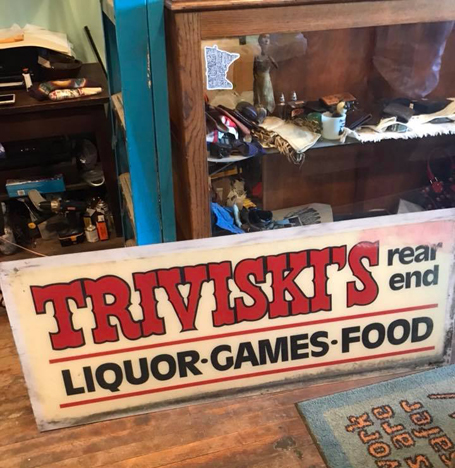
Image courtesy Steve Darwitz
Triviski’s was damaged by a basement fire and closed on September 9, 1974. Arson was suspected. The arsonist finished the job with a firebomb thrown through a window on September 30, 1974.
The site is now a parking lot.
Lyle M. Triviski died in 1988 at the age of 68.
The Trocadero Stage Bar was at 375 Wabasha near 5th, St. Paul in 1944 – October 1947.
That April “Jeanne Williams, Celebrated Vocalist and Musician, entertaining you Afternoons, Jack Wedell and His ‘Sweet Swing Sway’ Quartet Afternoons and Evenings.”
November 1950 – University Ave. Upstairs and downstairs rooms. Upstairs candlelight with Dixieland.
251 Second Ave. So., Minneapolis 1947 – 11/59
Owner George R. Keys
Demo for Gateway
December 1948 – man stole a guy’s accordion he was playing.
Please see the White House.
*** Pay no attention to this ****
About 1950 the bar changed hands again, and a new name emerged—the Turf Club, a name thought to derive from the stables, racetrack, and clubhouse built nearby in 1881 by Norman Kittson, merchant and one-time mayor of Saint Paul. “Kittsondale,” as this racing empire was called, was demolished in 1942. The bar was a community meeting place during the 1950s, with a meeting room called “The Lion’s Den” reserved for meetings of the Midway Lion’s Club.
According to the website tcmusic.net, the Turf Club had a “reputation as the Twin Cities’ foremost place for country two-stepping long before line dancing became a pop-culture phenomenon.” It’s known today as the “best remnant of the 1940s,” and one of the Twin Cities’ most popular venues for live music.
An early and enduring feature was the Clown Lounge basement bar.
In late 2013 First Avenue purchased the Turf Club. On its web site it says, “Opening in the ’40s as a two-steppin’ country bar, mellowing a bit through the folk artsy ’60s, morphing with the dance wave of the ’70s, then embracing the grunge of the ’80s, the club is like a treatise on Minnesota music. And this brings us to the other part of the club’s success: its consistent dedication to local and independent music, something this town of ten thousand musicians definitely recognizes and even appreciates enough to maintain loyalty in the face of an adverse location. So much so that the adversity becomes even more reason to frequent the damn place.”
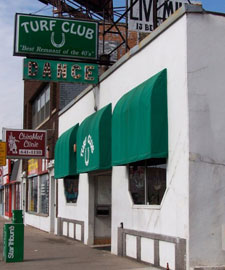
An updated Turf Club opened on August 28, 2014, after three months of remodeling.
**Note that there was another Turf Club in Minneapolis.
Please see Booker T. Barbeque Ribs
Much of the information below comes from Jim Sazevich, The House Detective.
The Twin Light Tavern was at 13 Leech Street at West 7th Street in St. Paul.
In 1898, the building was occupied by a widow lady, but four men were registered there for the census; part of the wild fight between Minneapolis and St. Paul to pad their numbers to be the top dog.
In 1901 it was Clarkin Brothers Grocery Store. Men excavating for a storehouse found a cache of coins amounting to about $10. Jim Sazevich says it was also an artificial limb store.
TWIN LIGHT TAVERN
The Twin Light Tavern was started in 1939 by Ralph M. Marrone and James P. Delmedico. The tavern had several different proprietors under that name until 1967.
In April 1944 there was a fire that spread so fast that the fire station next door had to call for additional apparatus. 70 patrons had to evacuate. The proprietor was still Ralph Marrone, who lived upstairs.
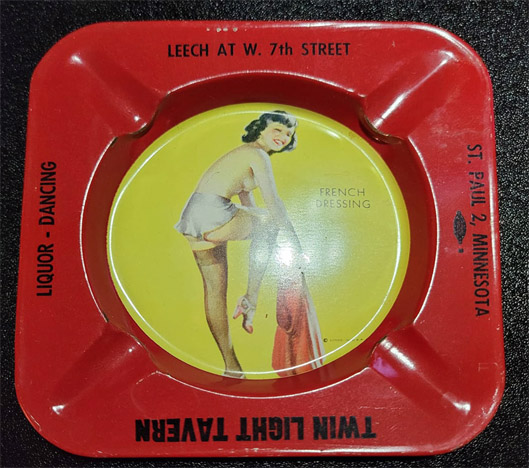
Image courtesy Adrian Aguirre
On February 3, 1952, the tavern got held up for a whopping $4,850 by “three rough-talking teen-agers” who shot the operator/co-proprietor of the bar, Elmer E. Rechtzigel, in the leg. Shortly afterwards, a gang of 12 males and 2 females were arrested for this and other stickups in the area. James Valentine, 17, was the shooter, who claimed he built up his courage by drinking at the Flame nightclub on Wabasha Street.
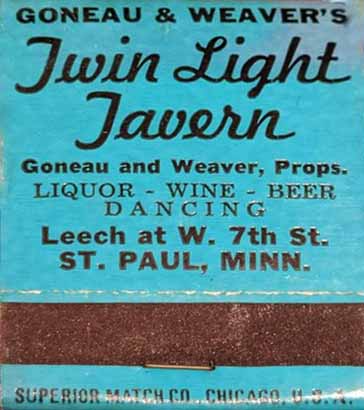
Twin Light Tavern Matches, courtesy Bob Jackson
On July 2, 1959, it was announced that E.J. Weaver, formerly with the Twin Light Tavern in St. Paul, was hired by the Roseville Municipal Liquor Store staff.
On March 20, 1960, an explosion caused a two-alarm fire that burned out the bar and caused $25,000 damage, forcing the lady who lived upstairs to vacate. She saved her dog Sparky.
They must have built back quickly; Augie Garcia had an extended engagement here in the summer of 1963.
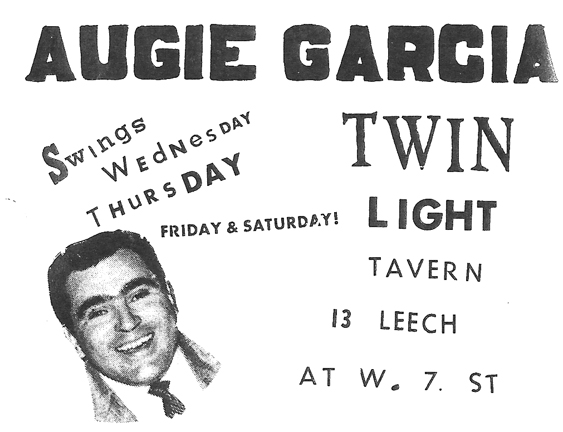
Image from Insider
Three men robbed the bar of $800 on December 17, 1963, but the law caught up with them in Miami after they returned from a trip to Hawaii.
A woman stabbed a man in the gut in a “cloakroom” in June 1967.
The last proprietor to use the “Twin Light” name was Edward E. Kelly until 1967.
TWIN LIGHT NO MORE
In 1968, the bar became “Brennan’s Liquors,” operated by Larry Brennan.
Later it became “Doug’s Place,” with Doug Laub as proprietor.
Finally, “Leahy’s Pub,” operated by Kevin E. Leahy, who was the last owner in 1977.
The building was razed in about 1981, and according to Lyfmap, the site is now a parking lot. Such is life…
The Twins Motor Hotel was at Prior and University in St. Paul.
In August 1969 they advertised an adult swinging singles… something. There were musical notes in the ad but the rest was up to you.
Please see the Depot for information about Uncle Sam’s and Sam’s.
The Unicorn Coffee House was located on Mayall Alley in St. Paul, from about 1962 to 1965.
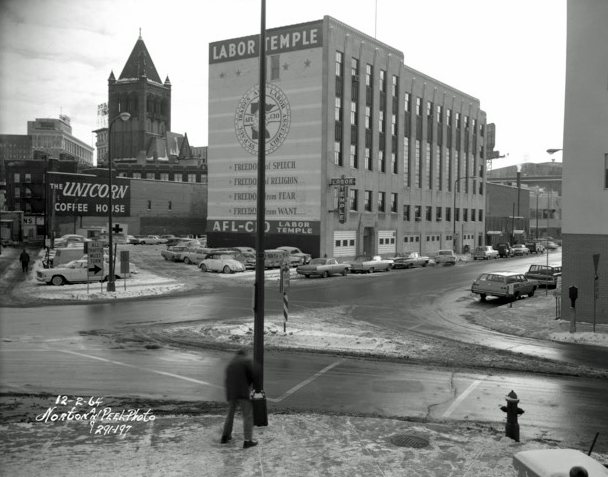
Unicorn on left, December 2, 1964. Photo courtesy Minnesota Historical Society
MAYALL ALLEY
Although there seems to be some controversy in people’s memories as to where the Unicorn was actually located, a menu posted on Facebook by Kathy Wilken establishes that it was, in fact, accessed by Mayall Alley. In the photo above, you see a sign for it on the left. The St. Paul Labor Temple was on Auditorium Street, which no longer exists (the building or the street). The map below may help sort this defunct geography out, but I’m not good at reading maps, so you’re on your own!
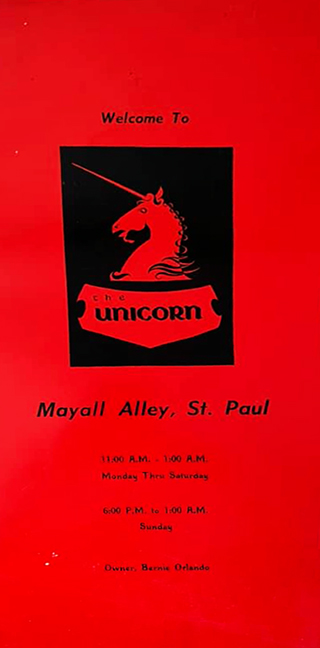
Image courtesy Kathy Wilken
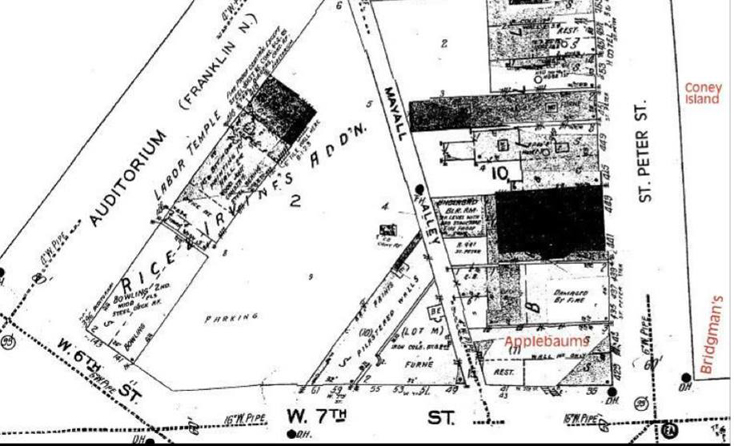
OWNER
Again, Facebook folks had differing memories about who owned the Unicorn:
One habitue remembered that a man named Marvin Gardner was running it. Another says that one of the owners was Eugene Cassidy. But as we can see, again from the menu, the owner, at least for a time, was Bernie Orlando. In fact, Orlando was Kathy Wilken’s cousin, which is probably why she still has this menu! Gene Cassidy may have been a co-owner.
THE MENU
The Unicorn Coffee House was just that, serving no liquor.
Former beatniks remember drinking ginger beer and eating delicacies like chocolate covered ants and honeyed bees!
Don’t know if you can read this actual menu below, but there’s nothing odd on it, just non-alcoholic drinks, pastries, and sandwiches. Apparently customers or others came in with the edible creatures to sell to the beats.
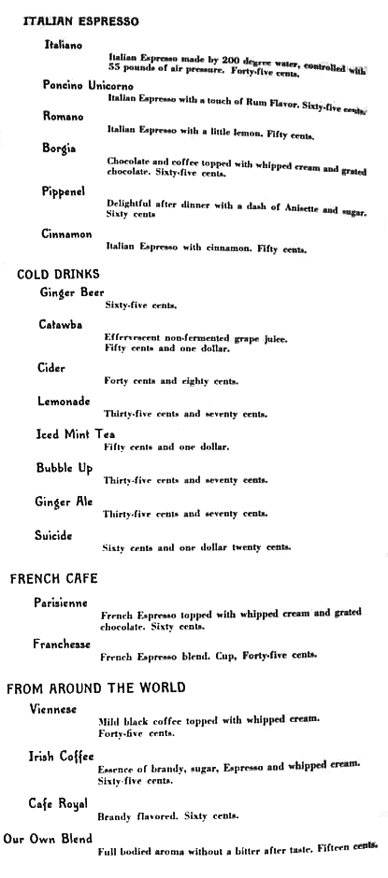
Page 1 of Menu – courtesy Kathy Wilkin
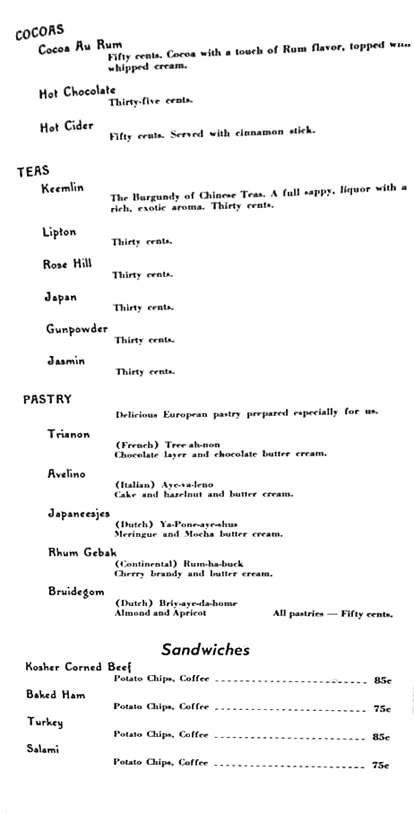
Page 2 of Menu, courtesy Kathy Wilkin
AMBIANCE
One young girl remembers it being dark and scary – and a velvet couch.
As for entertainment, if there was any it would be a solo performer with a guitar, singing folk music (Dylan was reportedly never there). The place was too small to accommodate a band, and inappropriate for rock.
There were blue lights inside and the beatniks applauded by snapping their fingers.
No one yet has apparently come up with a photo of the inside. I hope they post it on Facebook!
In progress.
EAST HENNEPIN CAFE
This “Workman’s saloon and hash house,” as described by the Star’s Don Morrison, was located at 507 East Hennepin, and went back to the 1920s. In 1937 it played a role in Kid Cann’s alibi during his trial for the murder of Walter Liggett. Stay tuned for that story!
http://www.mnbs.org/Union_Bar_History.pdf
This page covers:
- Union Hall, and
- Hallie Q. Brown Community Center
UNION HALL
Union Hall was located at 553 Aurora Street (at Kent) in St. Paul.
On March 13, 1914, representatives of Mars Lodge of Odd Fellows and Perfect Ashlar Lodge of Masons met at the home of Mr. Richard M. Johnson and created the Union Hall Association. Building a hall had been talked about for years, but had heretofore come to nothing. Finally, the Association had incorporated themselves for the purposes of building this $15,000 structure. (Appeal, June 27, 1914)
It took eight months to work out the contract, which was drawn up by attorney W.T. Francis. Francis was quoted as saying that the agreement was “horse high, bull strong, and pig tight.” Ground was to be broken on October 7, 1914. (Appeal, October 3, 1914)
The Cornerstone of the building was laid on December 13, 1914. Cold weather kept many away, but several hundred attended ceremonies at the Hall and at St. James AME Church.
On December 16, 1914, a celebratory dance was held to herald the Laying of the Corner Stone. Apparently the Hall itself was not ready for customers, so the dance was held at Bowlby Hall, at the corner of Sixth and Robert Streets.
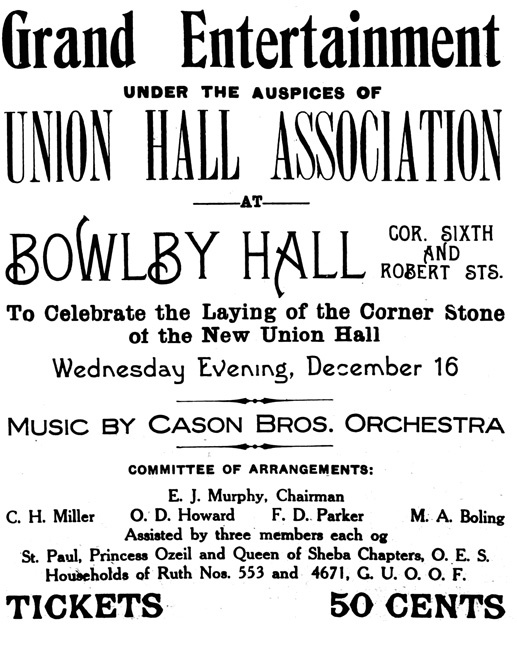
Appeal, December 5, 1914
Construction went on throughout 1915, and the Grand Opening Reception finally came on Monday, November 8, 1915. Beforehand, the Appeal effused,
Great credit is due to the men who helped to bring about this much needed building to which we can point with pride and say “this is ours.” The building is plain and substantial and is composed of two stories and a large basement and at present is the meeting place of every fraternal body in this city. (November 6, 1915)
After the Ball, the Appeal reported that 400 ladies and gentlemen had crowded the auditorium to take place in the formal opening. The dance floor was said to be 43 by 70 ft. in dimension. The program was a mixture of speeches and songs before the dancing began, with music by the Cason Bros. (November 13, 1915)
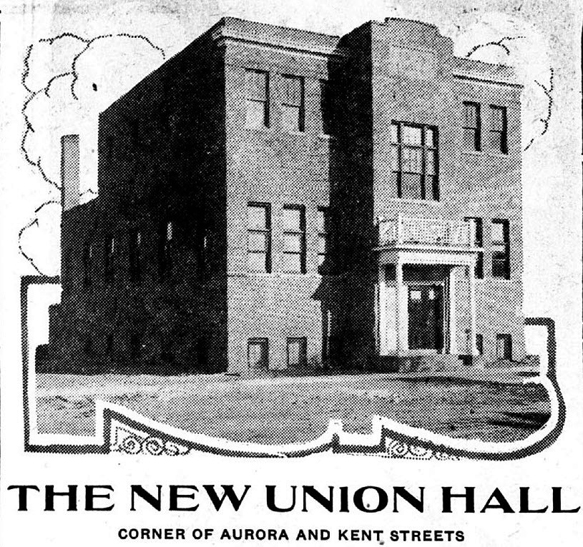
The Appeal, November 13, 1915
St. Paul’s Black community used the building extensively for dances, according to ads found in the Northwest Bulletin in 1922 and 1923. Unwelcome at the Downtown night clubs, people would form their own fraternities, sororities, or other clubs and then sponsor dances in rented dance halls like this one.
Here are just a few:
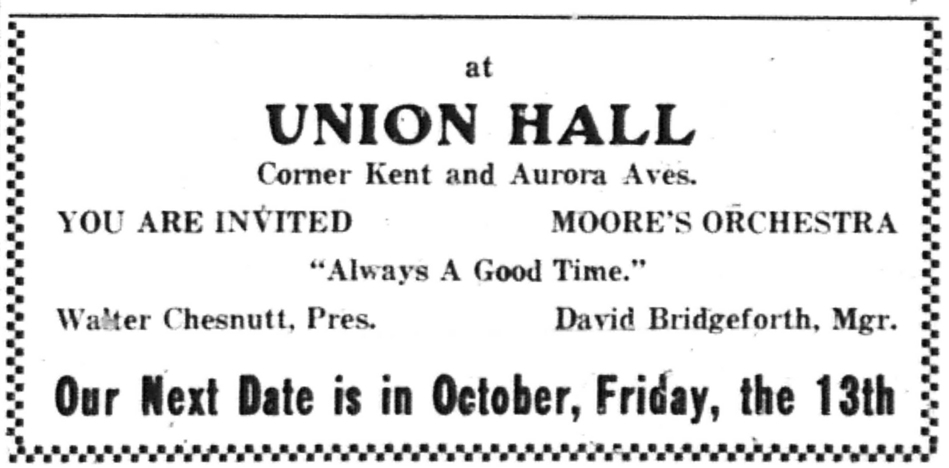
Northwestern Bulletin, September 23, 1922
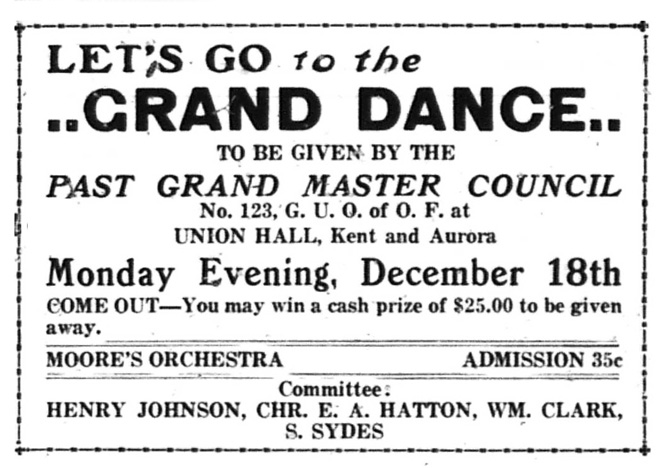
Northwestern Bulletin, December 1922
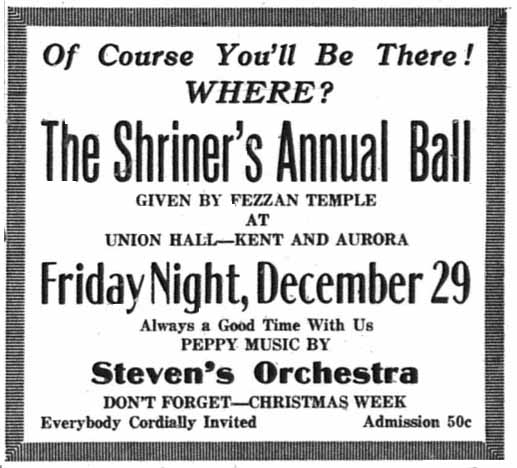
Northwestern Bulletin, December 29, 1922
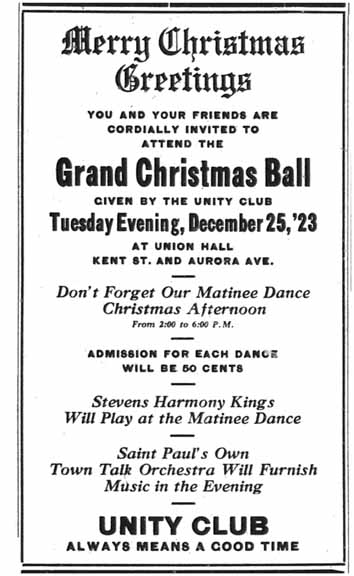
Northwestern Bulletin, December 25, 1923
Bill Moore’s Orchestra was one of the most popular in the Twin Cities.
The mortgage was paid off in March 1923:
What may be regarded as one of the most impressive events in the history of the Negro in the Northwest besides being a signal achievement throughout the fraternal world of Colored America was the public reception Tuesday night … at which time the mortgage on the hall building was burned, making the property free of indebtedness and the first building to be built, maintained, and paid for by Negroes in the Northwest. One of the most remarkable featured connected with the deal was the fact that it only took eight years to pay for the building. (Northwestern Bulletin, March 17, 1923)
THE HALLIE Q. BROWN COMMUNITY CENTER
The Hallie Q. Brown Settlement House was established to meet the needs of the underserved Summit University area of St. Paul. Its namesake, chosen by an essay contest, was an African American educator, elocutionist, women’s suffrage leader, and author. From 1923-1929, the St. Paul Urban League and the YWCA contributed funds and other support for a service center in the building. In 1929 its first home was the former Central Ave. branch of the YWCA.
Somewhere between 1929 and 1934, the Union Hall property became the Hallie Q Brown Community Center. It, too, was the site of dances sponsored by local clubs.
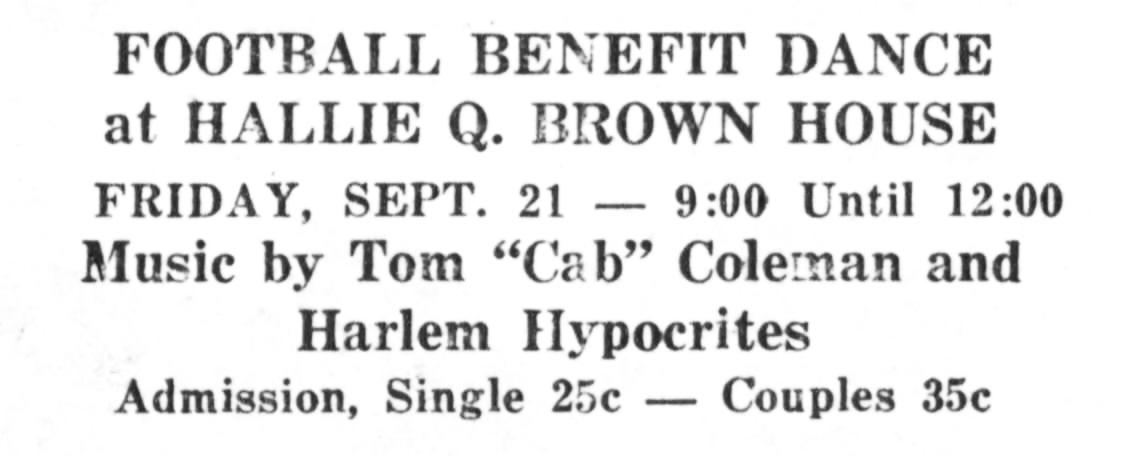
St. Paul Recorder, September 14, 1934
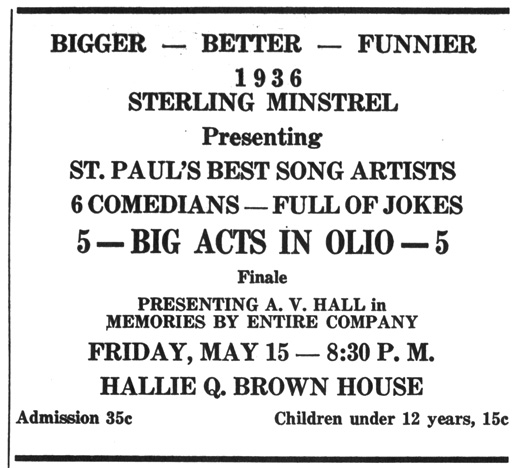
St. Paul Recorder, May 1, 1936
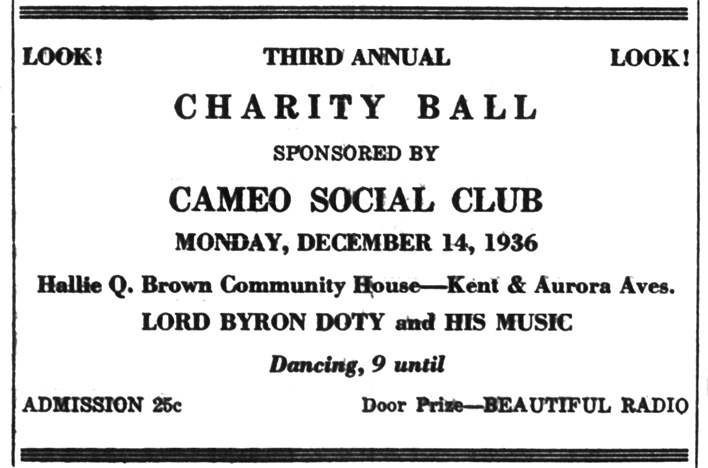
St. Paul Recorder, December 4, 1936
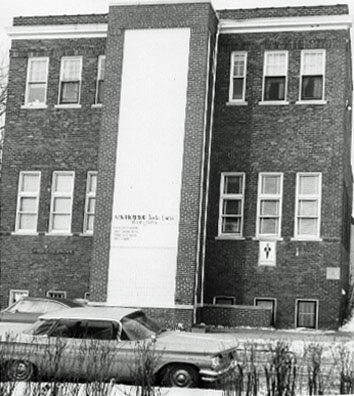
Hallie Q. Brown building in 1940
During the years before 1948, when black entertainers could not stay at downtown hotels, many would stay at Hallie Q. Brown.
In 1972, the Hallie Q. Brown complex moved to its current home at the Martin Luther King Center at 270 No. Kent.
This page is intended to cover a variety of places on the East Bank of the U of M. Please see separate pages for:
Many of these events took place outside, usually in front of Coffman Memorial Union (CMU) or Northrop Auditorium. As usual, they will be listed in chronological order as I’ve found them, and the list stops after 1974. Although there was a lot going on, especially during the turbulent days of the Vietnam War, I am trying to keep this page to musical events. For more information about anti-war protest activities, you may want to look at my page on the Vietnam War on the St. Louis Park Historical Society’s website. It has a skew towards SLP, but it also tries to relate the major actions of the war and the protest at the U of M, as told by activist Ed Felien.

1941 photo Courtesy Minnesota Historical Society
Above is a scene from outside CMU: Tom Morgan on Sax, Ira Pettiford on trumpet, Dale Olinger on trumpet, Oscar Pettiford on bass, drummer unknown.
1944: Al Wiklund taught jitterbug lessons at CMU.
1950s
The U of M held its Black Book Dance on April 25, 1952, in the Union’s Main Ballroom with music by Dick Kast and his Orchestra. In an ad in the Minnesota Daily, Men and/or Boys were invited to meet “Stenos, Models, Nurses, Receptionists and Coeds; – over 2500 girls attended last year’s dance,” it promised. “Friday is Your Night to Make Out!” Apparently this was an escapade of the Engineering school, which in the ’50s was bereft of women. At the dance Queen Colleen of the Engineers would be crowned, and the boys were exhorted to fix up dates for the engineers’ crawl on May 10. At some point in this silliness the engineers would present the opera “Il Cuspidore.”
U of M President J.L. Morill banned Paul Robeson from performing at the University, calling him an “embittered, Anti-American, Anti-democratic propagandist.” Robeson was not deterred, performing at the Union Men’s Ballroom (could this be the CIO Hall?) on June 3, 1952, in a show sponsored by the Young Progressives of America, reported the Minnesota Daily.
The U of M’s Homecoming Dance featured the Four Aces on November 1, 1952. There were also three orchestras.
Songstress Sunny Gale was the featured artist at the 1953 Sno Ball at the U of M, January 24, 1953.
Buddy Morrow played at the Stardust Dance on April 18, 1953, at the U of M.
Felicia Sanders, the Voice of Moulin Rouge at the Radisson Hotel, appeared at a dance at the Union Ballroom at the U of M on October 8, 1953.
The 1953 Homecoming Dance at the U of M featured Freddy Martin and his Singing Sax in the main ballroom, Doc Evans in the main lounge, Bill Lawrence and Dick Finch in the Armory, and Dick Marrone in the Cafeteria. All this on November 7.
Ray Anthony played for the Sno-Ball on January 22, 1954, at the U of M Union Ballroom.
Louis Armstrong provided the music for the Stardust Dance at the U of M on April 24, 1954.
BEATNIKS IN THE CITIES?
The October 1, 1959 Trib posed the question: “Does the Twin Cities have its share of beatniks? The people interviewed were skeptical:
- Suzanne Wolfe said “Yes, even if the majority of beatniks aren’t serious about it. There are a number of beatniks at the U of M. They wear trench coats and goatees.
- Errol Kantor said “No. Most beatniks are out in California. The fellows at the University who wear trench coats and goatees are all pseudo-intellectuals.
- Sonja Blagen thought Minneapolis had its share but that St. Paul didn’t have one beatnik joint.
- Matthew Levison, a student at the U, said “No. Perhaps 10 percent of those popularly known here as ‘beat’ are actually so. The balance are nothing more than hangers-on. Beat movement is entirely nihilistic in 20th century tradition. Its center is New York and the West Coast.
- Bonnie Erickson made the decision unanimous: “The concentration of individualistic existentialists, as I prefer to call the ‘beatniks,’ is definitely in Minneapolis. Only a few are sincere iconoclasts. Fakes who claim to be beatniks do it for attention, rather than for a purely esthetic cause.
In 1959, no rock ‘n’ roll was played on radio station WMMR, which was broadcast from Coffman Union to the dorms. Park senior Irwin Gold a/k/a Dean Curtis reported that its repertoire was easy listening and swing.
1960s
The Trashmen played a rare local gig at a Hawaiian Surfari at Coffman Union at the U of M. With special entertainment: exotic dancer LaLoni! Prizes for the Swingingest Hula Dancer, Brightest Shirt, Brightest Muu Muu. April 30, 1965.
The Trashmen were back at the U on September 20, 1965.
Herb Alpert, Blue Cheer and the Castaways (an odd grouping to say the least) played Williams Arena at the U of M on May 11, 1968. Nearly 17,000 attended.
MY LAI MASSACRE
The My Lai Massacre, which took place in March 1968, hit the media in November 1969 and was responsible for people calling veterans “baby killers” upon their return to the States. The news precipitated the International Student Strike Against the Vietnam War on November 13, 1969.
First, the band Phantasmagoria played on Northrop Plaza from 11:00 to noon. The band was made up of students from St. Paul Murray High School, including Arne Shulstad, who reported – then and now – that it was really too cold in November to be playing guitar outside. The Minnesota Daily – and I – will delicately delete the expletives. Arne says, “We got that gig because a friend of our bass player was in the Socialist Workers Party, which was partnered with the Student Mobilization Committee to End the War in Vietnam.”
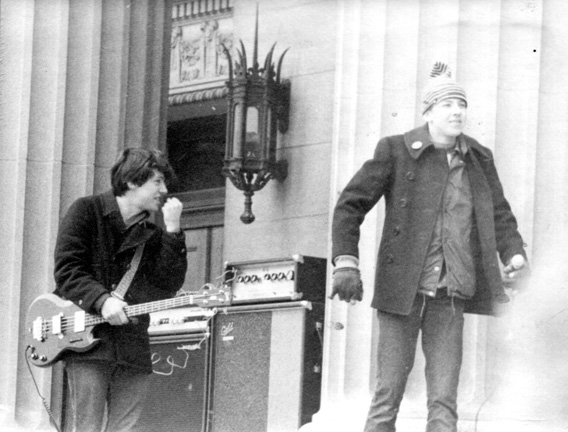
Phantasmagoria. Photo Courtesy Arne Shulstad
Then came a noon rally at Northrop Auditorium with speeches.
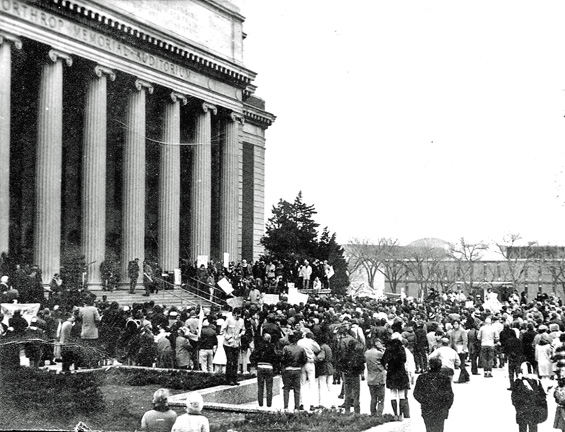
Next, demonstrators marched to the Old Federal Office Building in downtown Minneapolis. The 20-degree weather and a blustery wind kept the crowd to about 2,500, down from the 10,000 that gathered on October 15, 1969. The crowd was reported to be mostly high school and college aged.
There was a 4:30 dance at CMU featuring local band Showtime I and II.
After a night rally at the Minneapolis Auditorium, the Tribune reported that “the first of an expected 1,000 or more Minnesotans left Thursday night for the mass antiwar march in Washington, DC on Saturday.” The first bus to leave carried students from Macalester College, St. John’s College, St. Benedict’s College and the University of Minnesota.
More on the Vietnam war at home, focusing on St. Louis Park, is available here.
1970s
Pepper Fog played at Coffman Union on January 13, 1970, at 8:00 pm.
Crow and Abraxis performed at Coffman Union on February 6, 1970.
CAMBODIA
U.S. and South Vietnamese forces invaded Cambodia on April 30, 1970. On May 1 President Nixon announced the expansion to the public. U.S. troops could go no further than 19 miles into the country, for no longer than 2 months. A student strike at the University on May 4, 1970, drew 8,000 people outside the student union lasting one week and involving one-fifth of the student population. Demonstrations took place for a week. On May 4, 1970, at Kent State University, a similar demonstration took place, but ended in tragedy when Ohio National Guardsmen opened fire on protesting students, killing four and wounding nine others. At least some of those killed turned out to be onlooking students, not protesters.
On Saturday, May 9, 1970, a March for Peace started at Hamline University and ended at the Capitol, with the slogan “No Business as Usual.” An estimated 40,000 people participated in the march, which was organized by Barry Knight. At the end of the march participants heard speakers such as Indian activists Clyde Bellecort and Dennis Banks, and the Paisleys entertained the crowd.
Big Mama Thornton appeared at the Walker (or Coffman Union?) on May 6, 1970.
U of M held a series of blues concerts on the Anderson Hall Mall. Mississippi Fred McDowell performed to an audience of 1,200 on July 22, 1970.
Jesse “Lone Cat” Fuller, a 75-year-old black blues singer and musician, performed at Eddy Hall Knoll, East Bank of the U of M, on June 30, 1971, reported the Star. “His performance on the guitar, kazoo, harmonica and fotdella (an invention of his own) is one of laughing, dancing, happy songs.” He decided on the one-man-band concept in 1951 when he wanted to form his own band but found it difficult to find dependable, capable musicians.
Minneapolis. Photo below from 1932 is from the Minnesota Historical Society.
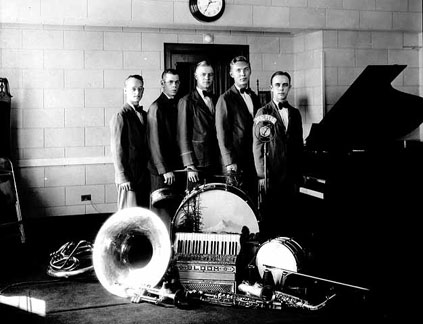
This fabled watering hole and rock club was located at 3018 Hennepin.
This establishment originated in the 1920s. Frank Toonen guessed that it had been the Granada Cafe in the 1940s. Toonen bought the bar in 1950 and served 3.2 beer. The first hit on the Strib database is in January 1950, advertising for a girl, single, under 30, to tend bar. One source says it was a blues venue in the fifties.
Toonen bought the property in 1960, and an article says that in the ’60s and early ’70s the bar featured Dale Thompson and his guitar, a fact I wasn’t able to verify. (Bream, April 4, 1996)
Toonen obtained a liquor license in the 1970s. The bar sponsored sports teams, showed movies in 1970, and hosted a pool tournament in 1972. In May 1971 people were urged to “Help celebrate the Depression – Wear your old clothes – Everything half price to unemployed girls.” This was a take on an old tradition of the “Hard Time Dance,” where participants competed to wear the worst clothes.
The photo below came undated, but the film “Nashville” came out in 1975.
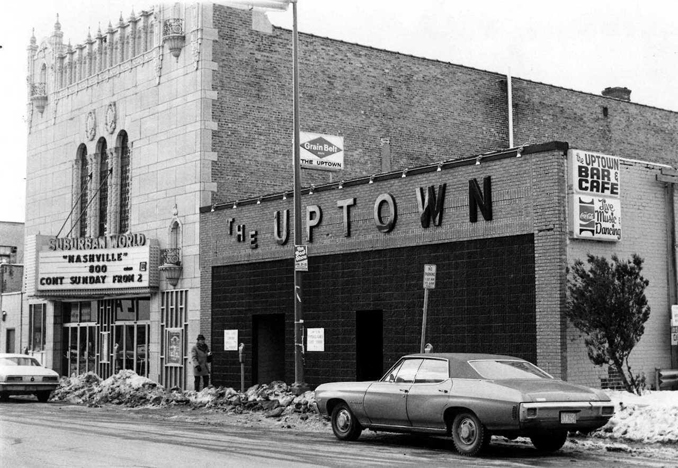
Photo courtesy Hennepin County Library
Someone said that the Uptown became a rock venue in 1974; bands were advertised off and on starting at the end of 1978. One of the bands to appear was Fatt City, in 1982. Until 1984 it was mostly a blues venue.
In 1984, Toonen sold it to Ray “Big Reggie” Colihan and Jim Loosen, a former contractor. They installed a stage and sound system.
Colihan hired Maggie Macpherson, who was responsible for booking the alternative bands that really put the Uptown on the map, in the days when the only other such venue was 7th Street Entry.
Big Reggie died in 1986 and Jim Loosen carried on until 1992.
Frank Toonen’s son Kenny took the bar back in 1992 – Dennis Willey became the bar’s general manager in 1995. Kenny put an end to live music in 1996, claiming that the bands were getting too expensive. Eventually live music returned, but it took time to regain its momentum.
Kenny Toonen died in 2008, and in November 2009 the bar was closed, razed to be rebuilt as a commercial building in 2010.
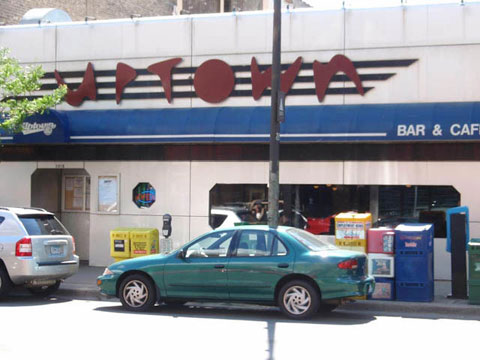
Photo by Barb Economon
The Valley Auditorium, later Valley Ballroom, was located in Chaska, just south of the Minnesota River, south of the Highway 41 bridge on the east side of the road. It was on the Scott County side of the River.
Much of the information for this page comes from an article in the book, Chaska: A Minnesota River City, Prehistory-1950, so kindly provided to me by the president of the Chaska Historical Society. That information will be annotated CHS.
VALLEY AUDITORIUM
Reviving memories of a previous Stege’s Park, a new Sugar City Park was dedicated on August 20, 1933, directly across the Minnesota River from Chaska. Ceremonies were to feature sports, a doll buggy parade for the girls, a dog parade for the boys, and dancing. The guest speaker for the proceedings was Roy J. Dunlap of the St. Paul Dispatch/Pioneer Press. (CHS) Grandstands for the baseball diamond were taken from the old ballgrounds bordering “the highway to Minneapolis” (Highway 41?) and moved to the new site by a group of citizens.
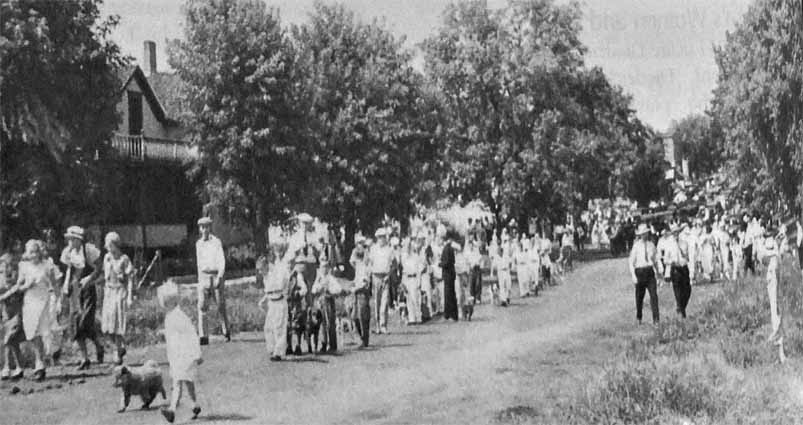
Opening Day Parade, August 20, 1933. Photo courtesy Chaska Historical Society
A dance pavillion, Valley Auditorium, was operated in the park by C.A. (Luby) and his brother Ray Lubansky, who led the movement for a park at Chaska. (Minneapolis Star, August 12, 1933)
Casimir Lubansky worked for the highway department after high school, and in 1933, he and his brother sunk their savings, a loan from their mother, and mortgaged everything they could to build the ballroom along the Minnesota River flats. Some of the workmen had to wait to get paid until after the ballroom opened, Lubansky remembered. (CHS)
The first dance brought in $1,500, according to Lubansky. Entertainment was provided by Wesley Barlow’s orchestra. Note that the ad below calls it the Valley Auditorium and Night Club! (CHS)
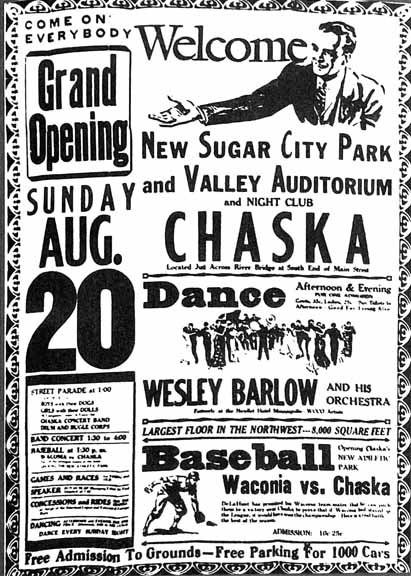
Image courtesy Chaska Historical Society
MUSIC AT THE VALLEY
Being outside of the Twin Cities, there don’t seem to be any ads in the Minneapolis papers in the early days of the Auditorium. There was one in the Minnetonka Record for a dance on September 17, 1933, featuring popular bandleader “Lou Breese and His 11-Piece Renowned Minnesota Orchestra,” and there may be many more like that. “The management has gone to extra expense to secure this attraction for its first appearance outside the Twin Cities. But admission remains at 35c FOR GENTS, 25c FOR LADIES. Night Club Open Always – Orchestra Music Wed. – Sat.”
Here is a rare ad from the Minneapolis press, no doubt published because of the star power of the orchestra leader, Lawrence Welk:
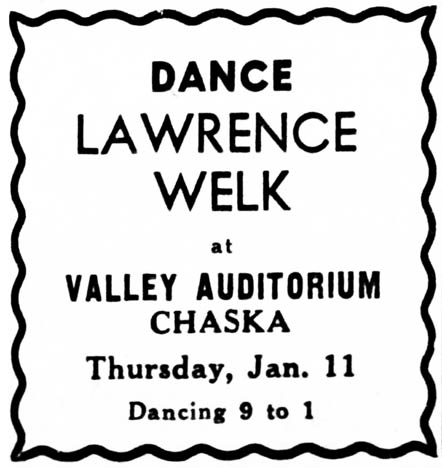
Minneapolis Star, January 1940
Welk made five appearances to the Valley Ballroom during his early career. (CHS)
The list of orchestras that came through the Valley Auditorium over the years is a long one, and the same musicians played all over the Five State area. Here’s just a sampling of those long-ago music makers:
- The Merry-Makers
- “Turk” Ramsey’s Pepper Shakers
- Jerry’s Bohemians
- Guy DeLeo
- Cecil Golly
- Whoopee John and His Six Fat Dutchmen
- Fezz Fritche
- Wally Pikal
- Ivan Kahle
- Ray Alderson
- Don Colburn
- Lee Williams
- Vern Wellington
- Dick Finch
- Bennet Greten
- Henry Charles
- Lynn Kerns
- Cliff Kyes
- Ray Winkler
- Clem Brau
- Joe Brabec
- Dick Kast
- Earl Huges
Some notable events were: (CHS)
The Battle of Music, between Bobby Griggs and his Waltz Kings and Tiny Little and the Texas Toe Teasers.
Lou Drews, who played his first dance job at the Valley, He went on to spend 20 years as the dance band at Chicago’s Chez-Paris.
One interesting note was that in the late 1930s, the jitterbug had taken the country by storm – a more athletic and enthusiastic version of the Lindy. Acceding to numerous complaints about the lack of decorum of these rowdy dancers, the Valley banned the jitterbug in 1939. (CHS)
VICE AT THE VALLEY
During the 1930s and ’40s, there was a Minneapolis vice crusader named Rev. Henry J. Soltau who made it his business to swear out warrants demanding raids on bars and night clubs that he suspected had gambling devices or illegal liquor. In 1940 he branched into Scott County. Whether as a matter of principle or in a feud with a competitor, Adam J. Happ of the Happ Ballroom in Shakopee swore out a complaint against the Valley Auditorium, charging Raymond and Casmir Lubansky with keeping gambling devices on the premises. Five slot machines were found in a raid at the Valley on September 24, 1940.
Soltau eventually went too far, securing 78 warrants for raids on Scott County night clubs and taverns (were there that many?) that were carried out on October 5, 1940. Not one gambling device or drop of illegal liquor was found, and on October 6, a judge filed a warrant against Soltau, charging him with “noise, riot, and disturbance,” after earlier refusing to sign 150 more warrants Soltau presented against Scott County establishments for gambling and liquor violations. (Minneapolis Star, October 6, 1940)
Another version of this story is that slot machines were legal in Scott County for a time, and each of the Scott County bars had 10 to 12 machines. The Valley had 12. It wasn’t until Luther W. Youngdahl became Governor of Minnesota in 1947 that slot machines were cleared out for good. (CHS)
VALLEY BALLROOM
The building seems to have been referred to as the Valley Auditorium in newspaper stories until October 1942, but ads for the Valley Ballroom started to appear in the Minneapolis papers in July 1941. (It may have also been known as the Sugar City Ballroom for a short time – CHS) Most of these ads were small and looked pretty much like the one below.
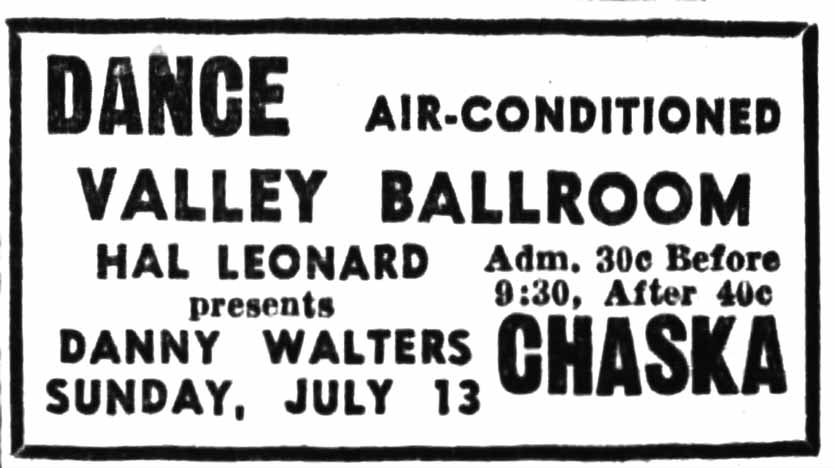
Minneapolis Star, July 11, 1941
The dance advertised below must celebrate the 90th Anniversary of the founding of Chaska, the “Sugar City.”
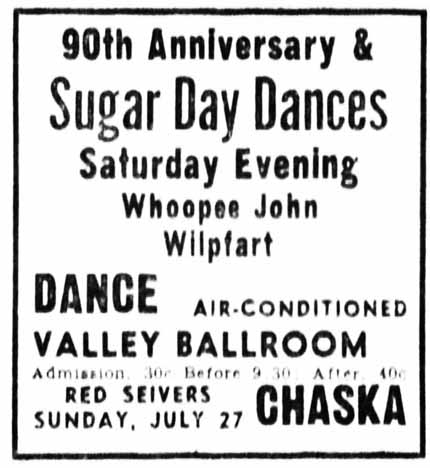
Minneapolis Star, Friday, July 25, 1941
In September 1942, a report of a robbery named the proprietor as James Lubansky. His name shows up again in September 1972 as the proprietor of a Gulf service station at Highway 494 at the 24th Ave. exit, until May 1974.
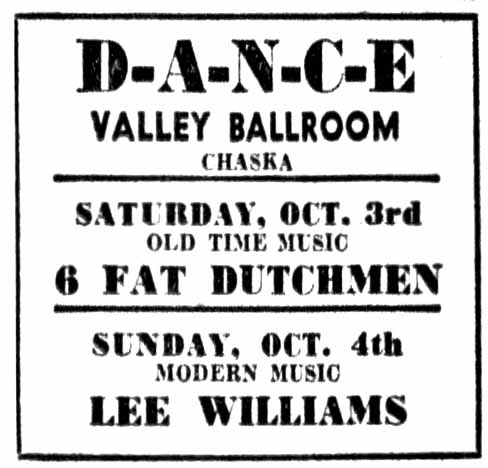
Minneapolis Tribune, October 3, 1942
The rest of the ads all look the same except for the names of the bands, so I won’t post them here.
FLOODING
Being so close to the Minnesota River caused real problems for the Valley Ballroom. In 1938 there was a danger of high water and all the fixtures were moved to the second floor, but the waters receded. In 1951 and 1952, they weren’t so lucky. Below is a photo from the 1951 flood.
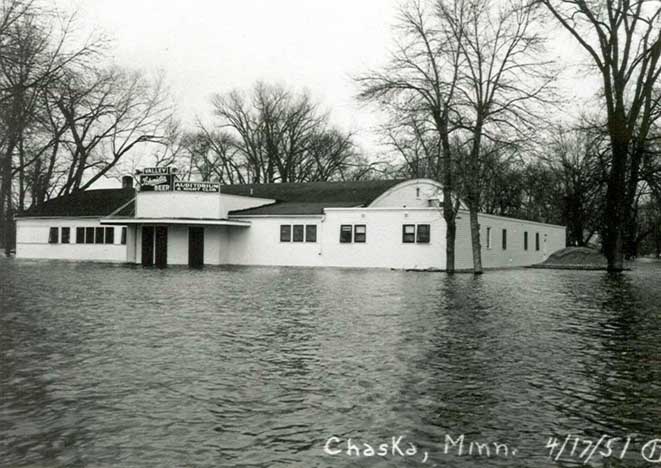
Valley Ballroom, April 17, 1951. Photo courtesy Chaska Historical Society
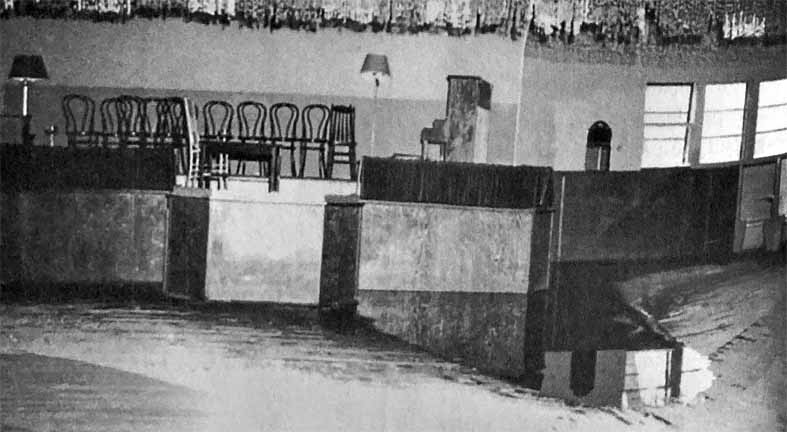
Inside the Valley during the 1951 Flood. Image Courtesy Chaska Historical Society
In 1952, George Grim titled his April 29 column, “Chaska Reels Under 2 Floods in 2 Years.” That year’s flood affected 600 of the town’s 2,000 people when the water rose eight feet over flood stage. He reported that the water buckled the dance floor of the Valley Ballroom down at the end of the street by the bend of the river. (Minneapolis Star)
The photo below shows Lawrence Welk, with owner Casmir “Luby” Lubansky, taken at the Welk’s TV studio, date unknown but probably in the 1950s.

Photo courtesy Chaska Historical Society
The photos below, of unknown source, show a truncated ballroom with one end removed.
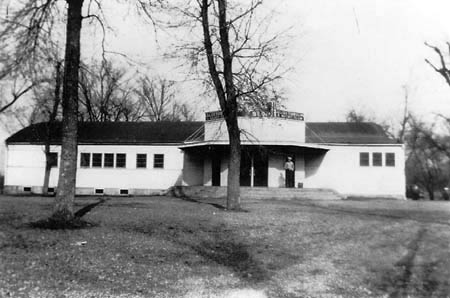
Valley Ballroom, 1959
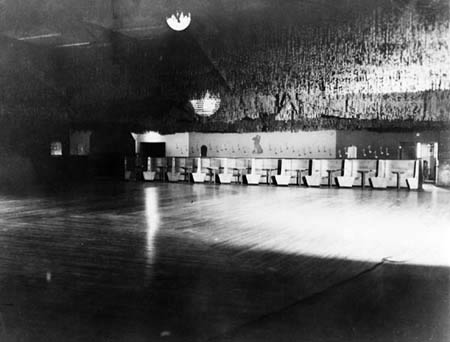
Valley Ballroom, 1959
END OF THE VALLEY
The beginning of the end came in the early 1950s when the ballpark in Sugar Park was lost because of a re-routing of Highway 41. (CHS)
The Chaska History Center provides this piece of news from a local paper:
July 9, 1959: A twenty-five year era as one of the state’s most popular dance spots is fast drawing to a close for the Valley Ballroom at Chaska. The Valley, a byword in dancing since its inception on August 20, 1933, is holding its final dances this month before a highway bridge project necessitates removal of the building. Owners Hildred and Casimer “Luby” Lubansky have scheduled three final dances.
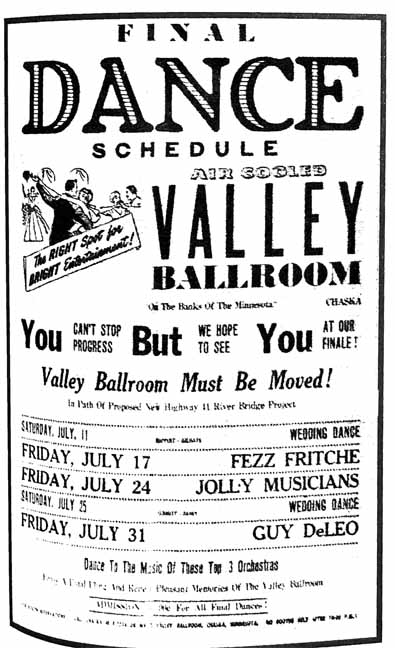
Image courtesy Chaska Historical Society
The last dance was held on Friday, July 31, 1959, with Guy De Leo providing the music. Another news item provided by CHS says that the Lubanskys were selling the Valley to the State of Minnesota as a part of a highway-bridge project.
CODA
One informant on Facebook noted that the building was moved after the 1965 flood to LeSeuer, Minnesota, where it was used for a roller rink. It may still exist as a dilapidated warehouse.
This page will cover the same property, which was in turn,
- The Valley House
- The Murphy House
THE VALLEY HOUSE
The Valley House Supper Club was first described as being located 1.3 miles south of the Mendota Bridge on Highway 13 in Eagan Township.
Highway 13 became the Sibley Memorial Highway, the building was assigned the address 2600, and the Mendota Bridge was replaced by Interstate 494. Eagan became incorporated as a city in 1972.
The Valley House was owned by partners Ray E. Goneau and Jeanne Lommen of St. Paul. The building cost $75,000 to construct and could accommodate 200 diners. (Minneapolis Tribune, April 13, 1957)
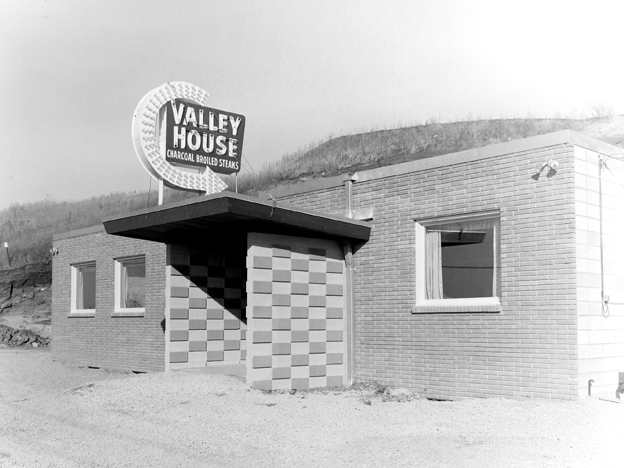
Photo from the St. Paul Dispatch, March 26, 1957
Supper Clubs usually have some music, and here is some evidence that there was music early on:
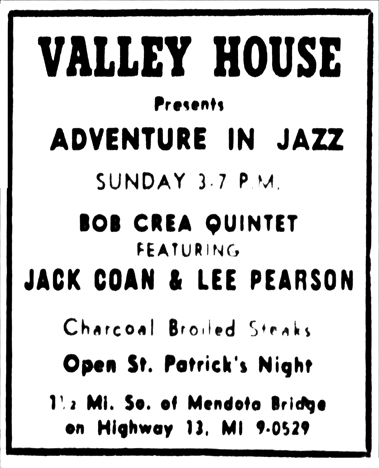
Minneapolis Tribune, March 28, 1958
The ad below was kind of hidden in a classified section. One wonders how such a stark-looking building would incorporate a “Rumpus Room!”
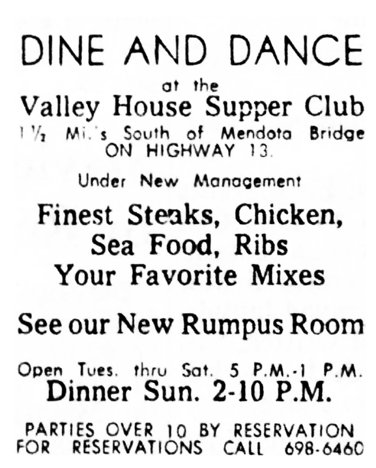
Minneapolis Star, September 14, 1962
On March 8, 1964, an ad announced that the Valley House was open under new management.
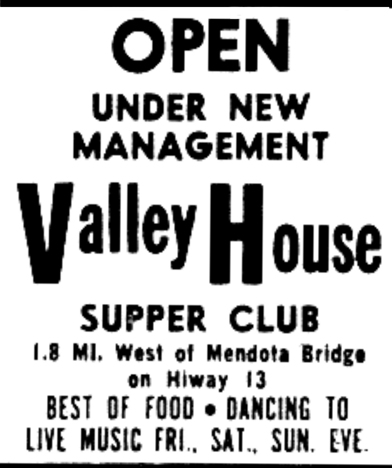
March 8, 1964
MURPHY HOUSE
Apparently the new management didn’t catch on, and the Valley House was sold to Ray Murphy in December 1964. Murphy changed the name to the Murphy House Supper Club, and advertised for an organist. The Grand Opening was on December 13, 1964.
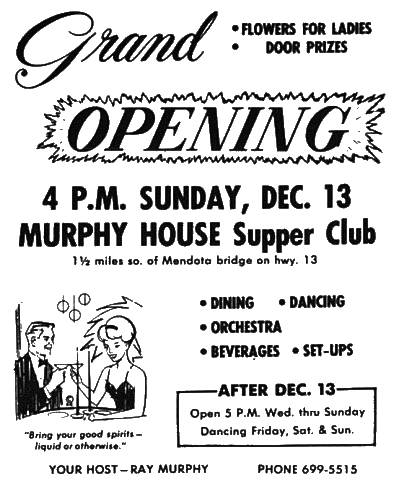
Image courtesy Burnsville Historical Society
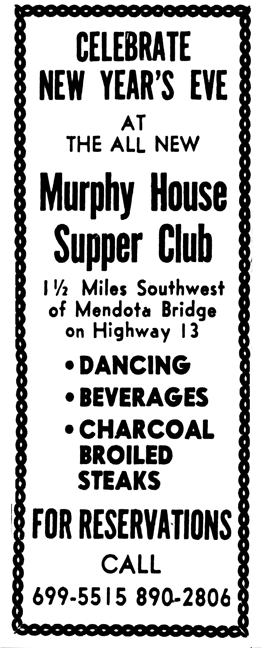
Minneapolis Star, December 30, 1964
LUNCH AT MURPHY HOUSE
Although the Murphy House was a Supper Club, one fellow on Facebook tells us that lunches were also available:
In the 1970s there were no restaurants in the area to grab lunch, but the Valley House had a buffet line set up in the bar with some of the best food around. Older women would bring in and set up these big old white pots full of chili, roast beef, fried chicken, etc lined up on makeshift tables in the bar. Workers for miles around would come and line up in the feed line for it. In the days before the predominance of fast food places, there were several bars and legion clubs like this around town transformed at lunchtime to accommodate the working men and women.
THE END OF THE MURPHY HOUSE
In November 1980, a notice appeared in the classifieds that the State has purchased their property and they were auctioning off their equipment. The old location appears to be right in the middle of Sibley Memorial Highway, at approximately Highview Avenue.
Valli Pizza’s Grotto Room in Dinkytown was a folk destination in 1962. Jerry Hatfield says that for many years The Bob Andre Trio for Jazz were regular performers.
This is the story of 23 North Sixth Street at Hennepin Ave., in Downtown Minneapolis. The building wasn’t known for any one major music venue, but several have lived there through its long life. I had to choose one for the title, so I chose the most colorful, even though the Vanity Dance Hall may have only been here for a couple of weeks.
Other venues were:
- The Modern Dancing School
- The King of Clubs (not the one in Northeast)
- La Casa Coronado
- And a host of restaurants and bars after my 1974 cutoff, including Chicago, Take Five, Cheers, Tobie’s, and Reilly’s.
The building was built in 1905 at a cost of $20,000 as a warehouse and store.
THE MODERN DANCING SCHOOL
This dancing school hired 30 women to give dance lessons to men, six for $6. The first ad, in the classifieds, appeared on January 1, 1924. Dances taught included the Valencia, the Black Bottom, and the Blues. Dances were accompanied by a live orchestra. By February the lady count was up to 70, and the ad read, “Age no obstacle.” In April 1924, the Tango was added to the list of dances taught. In 1926 the ad promised an easy method: “no embarrassment.” But that was November 7, 1926, the last ad.
One problem with this was that it was under scrutiny from the Women’s Co-operative Alliance, who thought it looked suspiciously like a taxi-dance joint. These proper ladies may have convinced the City Council not to renew R.J. Brewer’s dance hall license.
These ladies were also after S.D. “Dancing Dan” Stocking at his places at 242 Nicollet and 703 Hennepin, but he went on to teach dancing until 1984.
VANITY DANCE HALL
The next great venue at this address may have lasted only a couple of weeks, but it had a great name! The Vanity Dance Hall opened on December 14, 1946.
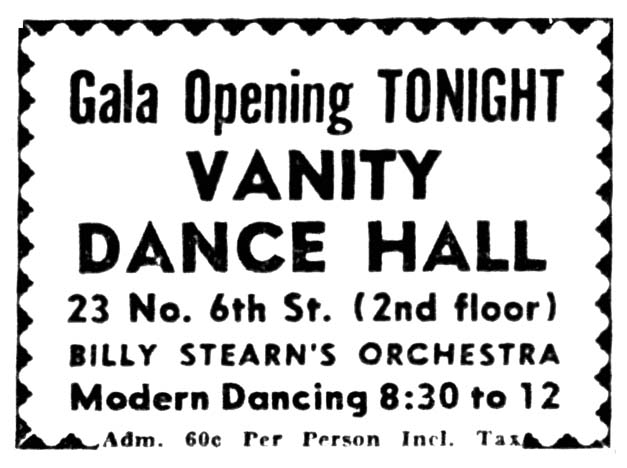
Minneapolis Star, December 14, 1946
After that, six identical ads to the one below were placed until December 31, 1946.
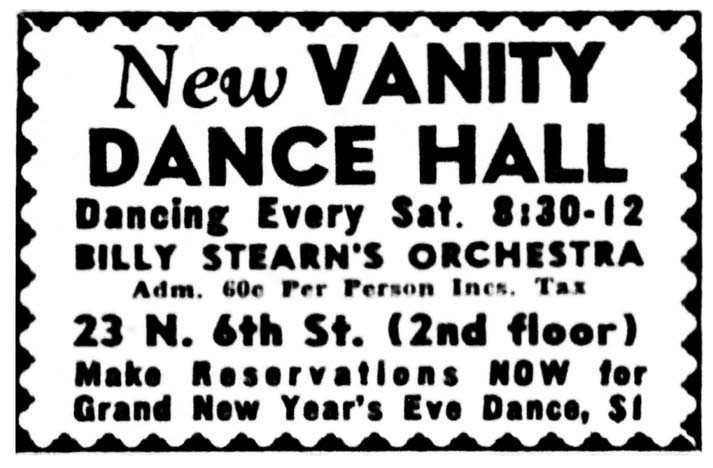
Minneapolis Star, December 1946
KING OF CLUBS
Not much was found about the King of Clubs, except what was in the few ads placed in the papers. Entertaining was Obie Sailin’s Well Known Swingsters.
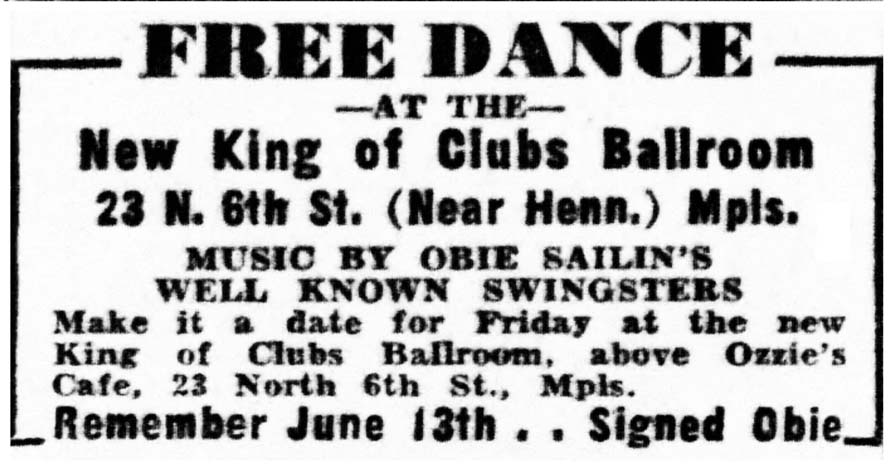
Minneapolis Star, June 12, 1947
The last ad wasn’t far behind the first. Here we learn that the manager was Reuben Olson, and that Obie had something to do with WDGY radio.
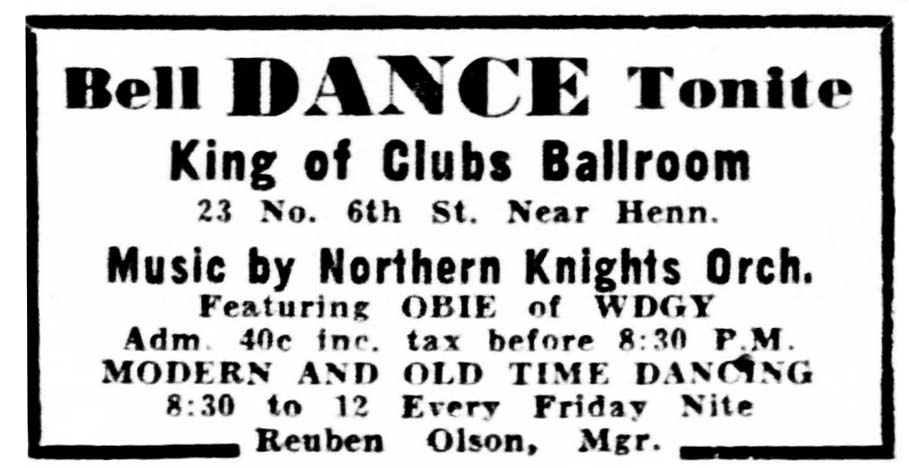
Minneapolis Tribune, September 19, 1947
LA CASA CORONADO
The next we see this address as a venue is as a hurried location of La Casa Coronado, after their last location suffered a fire. The famous Mexican restaurant had this address from April 1965 to 1979. See that story on their page.
As mentioned above, the space hosted a number of restaurants before the building was demolished some time after 1996. In 2001 the whole block became a hotel, with the address 601 First Street. Let’s hope there’s a place to dance.
Venetian Gardens sounded elegant, but was probably just the back yard of an obscure roadhouse in 1935. It would later become St. Louis Park’s landmark Brookside Drug.
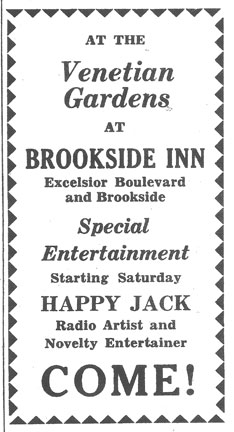
This restaurant was located at 2814 Rice Street, Little Canada.
It was started by the Vitale family Mama and Papa Vitale (Congie and Joe). Their grandson Joe provides these details:
They started the business in their home in 1928 when they first got married. They bought the property on the corner of Rice Street and Little Canada Road from Hamm’s Brewery for $750.
It started with a house and then grew to include a vegetable stand because my parents farmed. Eventually, Congie would start making Italian foods and serve it right out of the house.
They cleared out the living room and put a couple of tables in and used their own silverware. Eventually they converted the house into a restaurant in the front, and we lived in the back of it.
They never moved from that location through tornadoes and fires and kept expanding until 1963 when it was destroyed by a fire. At that point a new restaurant building was put up.
It was around for 73 years with good food and great shows and dancing in the Cocktail Lounge.
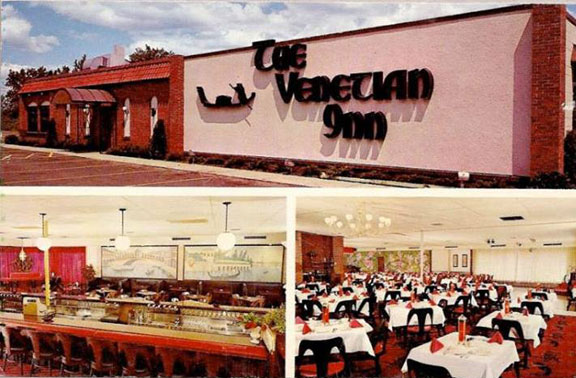
It closed on December 31, 2001, as Little Canada wanted to redevelop the area.
This page concerns the many, many dining and dancing establishments located at 507 Hennepin Ave., in the Hale Block at 5th and Hennepin in Downtown Minneapolis. For the history of that building, click here.
This is where the action was. For some reason, this address turned over – and over – and over – and was the location of the entertainment mecca of the Hale Block. Now, tracing the inhabitants of 507 Hennepin Ave. is a bit tricky, because that address might have been kind of fluid. A search through the newspapers yielded conflicting information:
- June 1880: Dyer & Howard was an early music store that sold sheet music, pianos and organs, and small musical instruments.
- 1894: Drug Store
- 1899: Wheeler and Wilson Sewing Machine Co.
- 1913: Saloon
- 1921: At the time of a big fire, three businesses were listed at this address: Silverman’s Grocery Store, Booth Fisheries, and Flood’s Market House.
- After the fire it was the Wholesale Candy Co., according to the ad below.
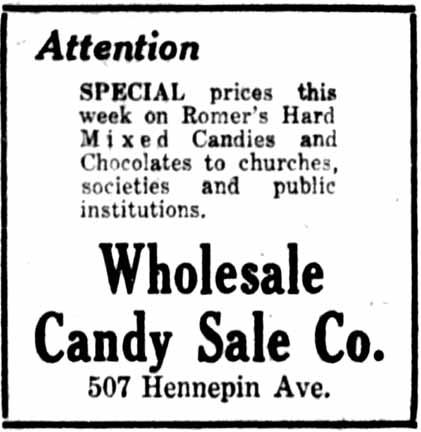
Minneapolis Tribune, December 14, 1921
- 1924: Warner & Co. Men’s Furnishings
- December 1928: The Cave, Abraham Bloom
- September 1929: Cafeteria
THE GROTTO
The Grotto featured the Grotto Cafe Orchestra, led by Sammy Scheiner, which broadcast over WRRM Radio. It operated from about March to December 1930.
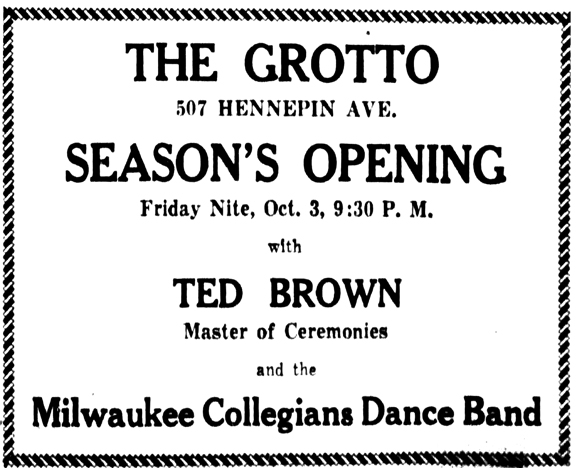
Minneapolis Tribune, October 11, 1930
NEW ENTERTAINERS CAFE
This enterprise apparently had one big New Years’ Eve blowout and disappeared.
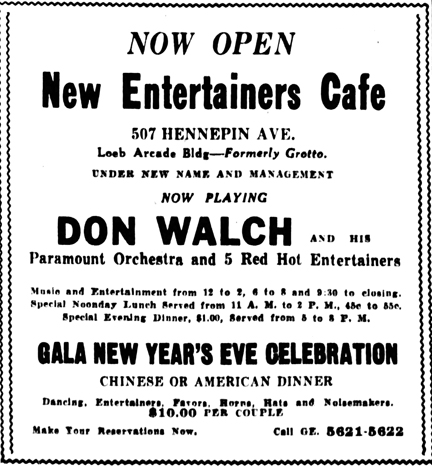
Minneapolis Tribune, December 27, 1930
PORTAL PLAYERS CAFE
The Portal Players Cafe was a kind of dinner theater that presented religious plays. It was around from about October 28, 1931 to April 1932.
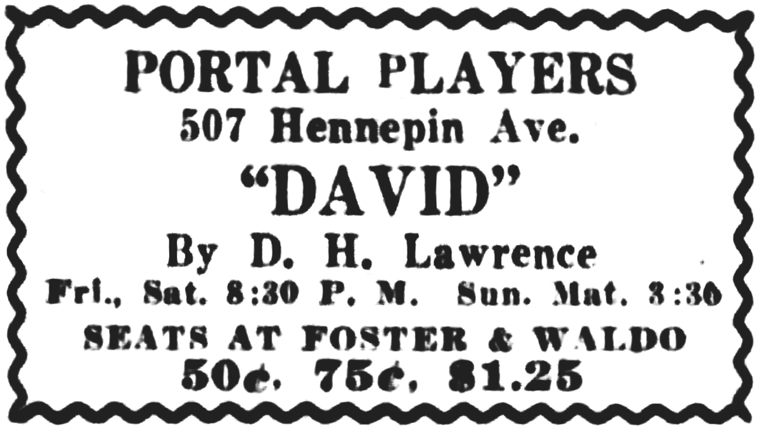
Minneapolis Tribune, November 27, 1931
THE COPPER KETTLE
Al Winger was the manager of the Copper Kettle, which was apparently just a restaurant that also served “real drinks.” These ads were the only evidence of its existence, however.
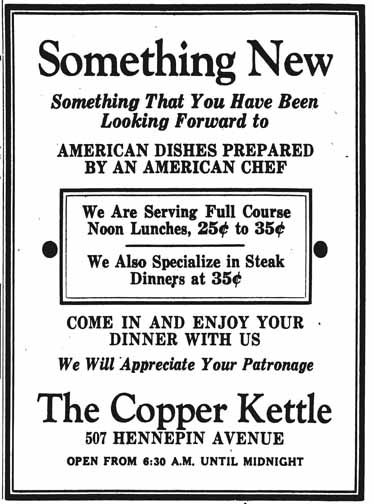
Minneapolis Star, January 27, 1933
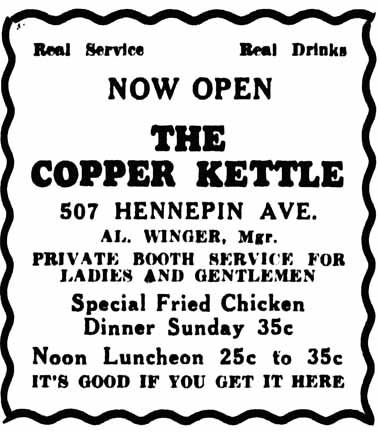
Minneapolis Star, February 4, 1933
THE HARBOR BAR
Andy Leonard got a liquor license on January 14, 1934, and started the the Harbor Bar/Cafe. It apparently coexisted with other clubs.
THE CLUB LIDO
The ad below tells us that the Club Lido opened on August 14, 1935.
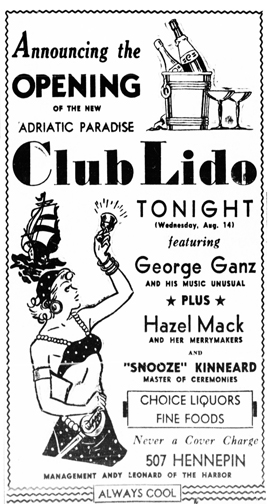
Minneapolis Tribune, August 14, 1935
Owner Andrew Leonard was jailed in February 1936 for selling liquor after hours and fined $75.
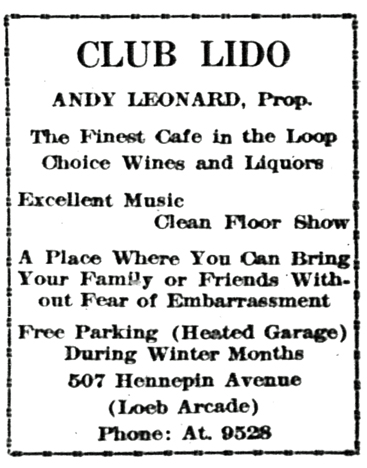
Saturday Press, December 1935
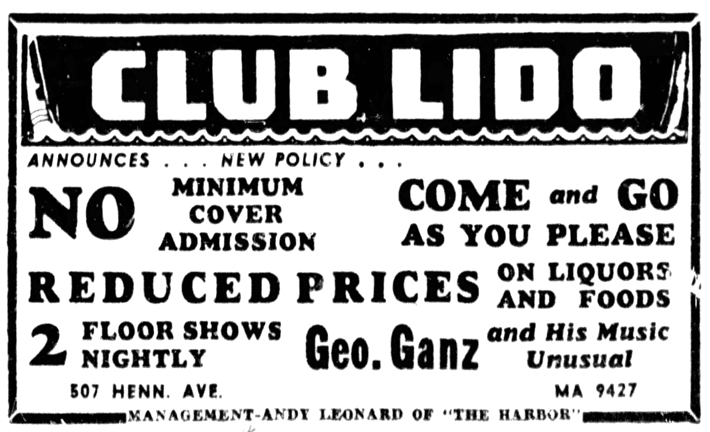
Minneapolis Tribune, January 18, 1936
OLSON’S HARBOR BAR
Howard C. Olson did 90 days in the Workhouse for serving liquor on a Sunday in November 1942. The Liquor license was revoked in January 1943.
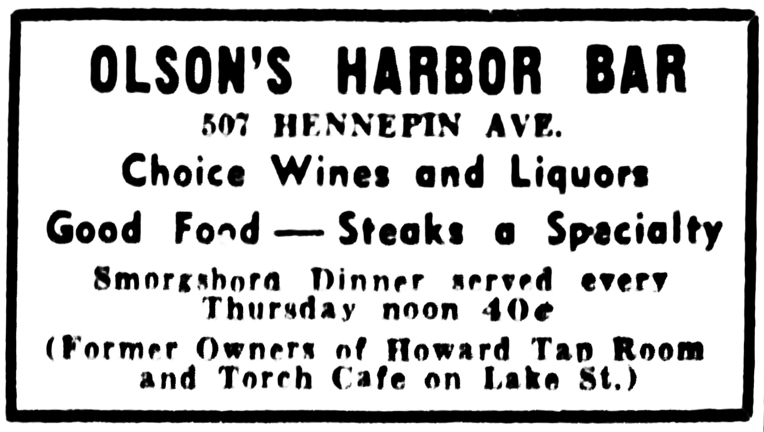
Minneapolis Tribune, March 8, 1940
DOME THEATER LOUNGE
The Dome opened on March 31, 1943, by Vic Levine, Sr. It featured mainly small, national jazz groups such as Henry “Red” Allen, Johnny “Scat” Davis, and Red Reynolds.
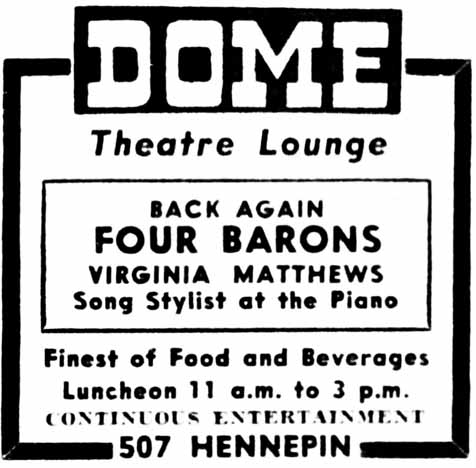
Minneapolis Tribune, January 21, 1944
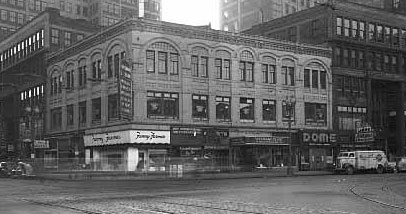
The Hale Block in 1946, with the Dome at far right. Photo courtesy Minnesota Historical Society
The matchbooks below are courtesy of the collection of Mark Youngblood.
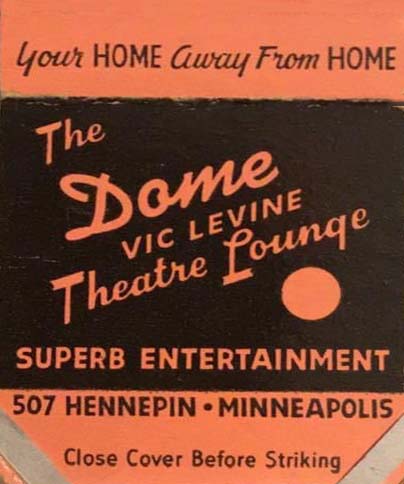
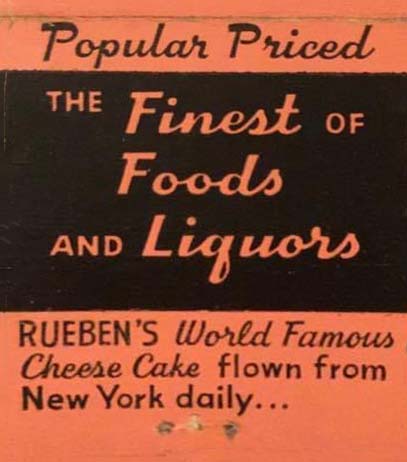
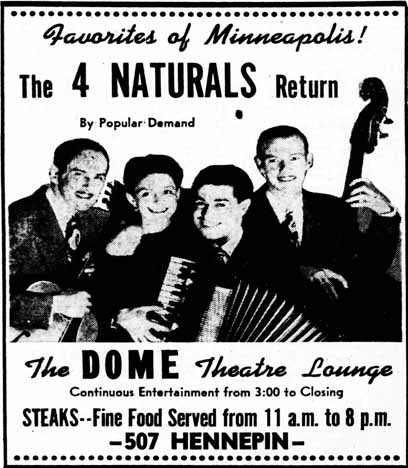
Minneapolis Star, May 2, 1946
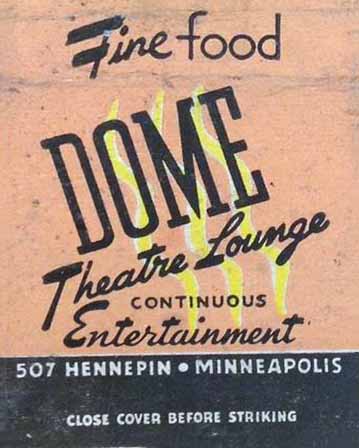
From the collection of Mark Youngblood
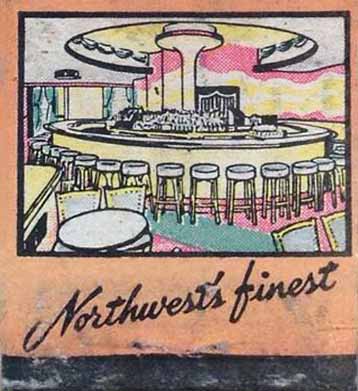
From the collection of Mark Youngblood
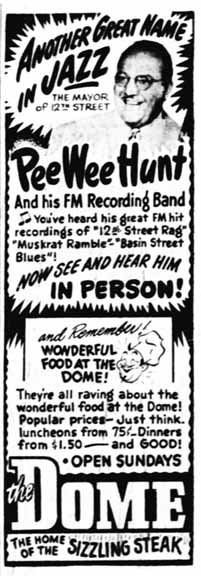
Minneapolis Tribune, February 18, 1949
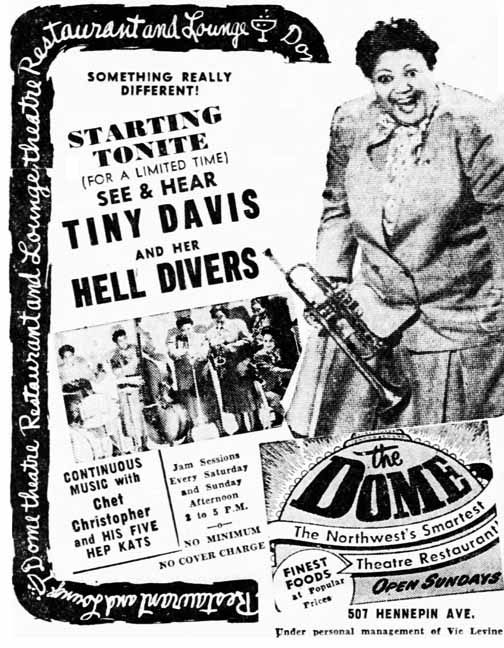
Minneapolis Tribune, January 30, 1950
Matchbook images below courtesy Gordon K. Andersen
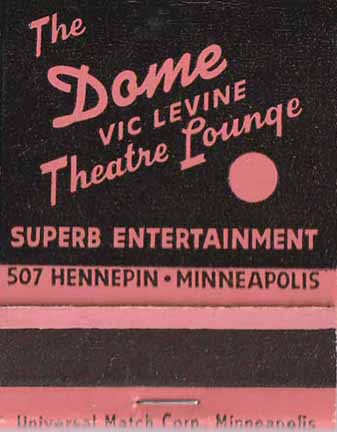
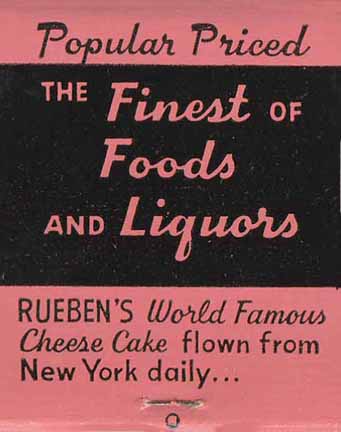
VIC’S
Vic sold the Dome in December 1950, but he bought it back in August 1951 and in October 1951 the club was reopened as Vic’s. Bob Davis’s Trio appeared at Vic’s from 1951 to 1957. In October 1952 the ad featured six acts, performing four shows nightly. “The best in the west!”
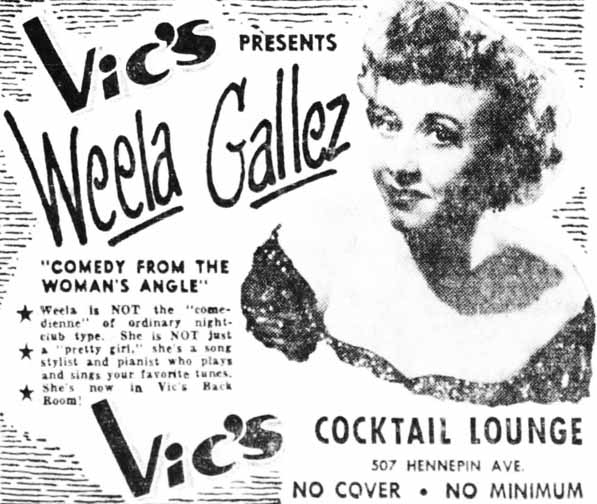
Minneapolis Star, March 11, 1953
JAZZ AT VIC’S
In the early 1950s, Vic’s hosted the best of jazz artists. Dig that “Royal Court of Jazz! Irv Williams on sax and Ira Pettiford (that’s a typo on the ad) on bass.
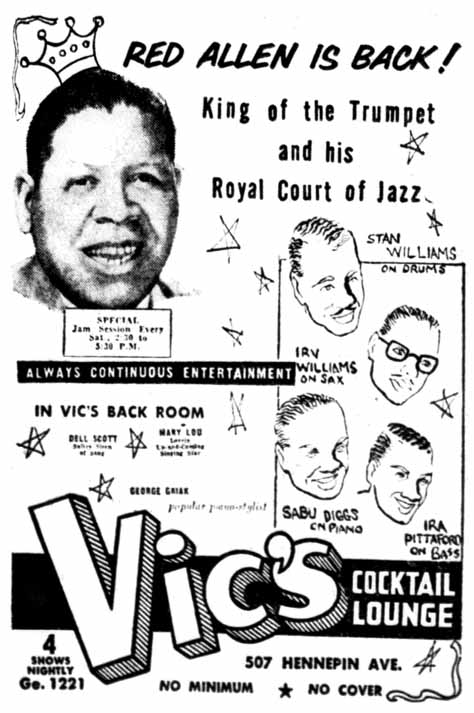
Minneapolis Tribune, January 27, 1954
Vic’s started advertising jazz performances in the Minneapolis Spokesman in April 1954, with Red Allen, “King of the Trumpet and his Royal Court of Jazz.” Later in 1954 Vic held a fabulous Festival of Jazz, with:
- “Wild Bill” Boone and His Famous Quartet
- Tommy “Madman” Jones and His Jazz Combo
- Lester Young “The Prez”
- James Moody
- Earl Bostic
- Big Jay McNeely
- Illinois Jacquet
- Joe Houston and His Jazz Combo
- Bill Doggett
Minneapolis Spokesman: “Hear the Twin Cities’ Finest Musicians.”
THE HALE BLOCK BURNS DOWN
On October 25, 1954, a spectacular fire swept through the original 1880 Hale Block, totally destroying the three-story building. Ten businesses were destroyed:
- Vic’s Restaurant and Cocktail Lounge, 507 Hennepin
- Foreman & Clark men’s clothing store
- Fanny Farmer Candy shop
- New West Shoe Repair shop
- Sunshine Florists, 503 Hennepin
- Arcade Men’s shop
- Loeb Luncheonette
- Twin City Loan Co.
- McGlynn Bakery
Big Jay McNeely’s band, which had been knockin’ ’em dead at Vic’s since at least May 1954, suffered an $8,000 loss in instruments and about 30 suits. A.B. Cassius headed a committee that held a benefit dance for McNeely on November 7, 1954, at the Labor Temple “so that they can get back to their homes and maybe a down payment on some new instruments.'” reported the Minneapolis Spokesman. “Hear the Twin Cities’ Finest Musicians.” The origin of the fire was traced to orchestra’s dressing room in the basement of Vic’s. Although arson inspectors attempted to determine the cause of the fire, the basement was so full of water and debris that an inspection was too dangerous. (Minneapolis Star and Tribune, October 26, 1954) At the time it was characterized as the year’s worst fire, causing damage estimated at $750,000.

Hale Block fire – photo courtesy Minnesota Historical Society

Hale Block fire – photo courtesy Minnesota Historical Society

Hale Block fire – photo courtesy Minnesota Historical Society
THE NEW HALE BLOCK
(It wasn’t called that anymore but I like the name) On the day after the fire, city building inspector Donald Erickson ruled that the owners of the building would not be able to reconstruct it, although the outside walls were still standing, because more than 60 percent of the building was destroyed. (Minneapolis Star, October 26, 1954) The old building was demolished (wrecking permit January 25, 1955). A building permit was approved to build a replacement building on April 25, 1955, in the same spot as the old one. The dimensions of this building were 83’ x 87’, and despite all those plans over the years to replace the Hale Block with a ten-story building, the replacement for the three-story structure was only two stories high. (It would have been three stories if NSP wanted the space.) The architect was Charles Hausler. This building stood on the corner for many years, anchored by Fannie Farmer.
MEANWHILE, BACK AT VIC’S
Vic’s temporarily moved to 314 Hennepin Ave. until the Hale Block was rebuilt. This location at 314 had formerly been Smitty’s Bar, which had had its license revoked in 1952 when a man picked up an 18-year-old girl there and then murdered her in a Skid Row hotel. It had been vacant ever since. (Minneapolis Tribune, December 9, 1954) A big ad in October 1955 announced that Vic’s was back at 507 Hennepin, and featured Lombardi’s Italian food.
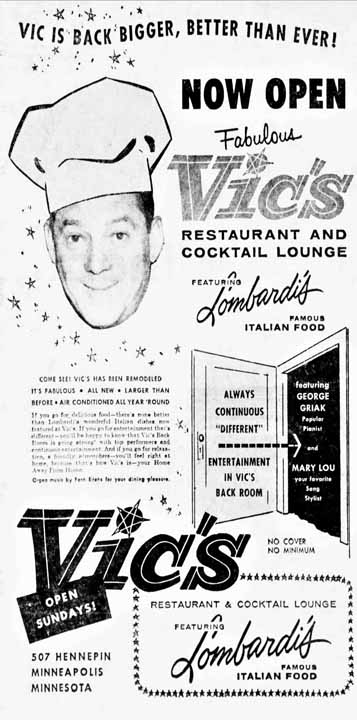
Minneapolis Tribune, October 21, 1955
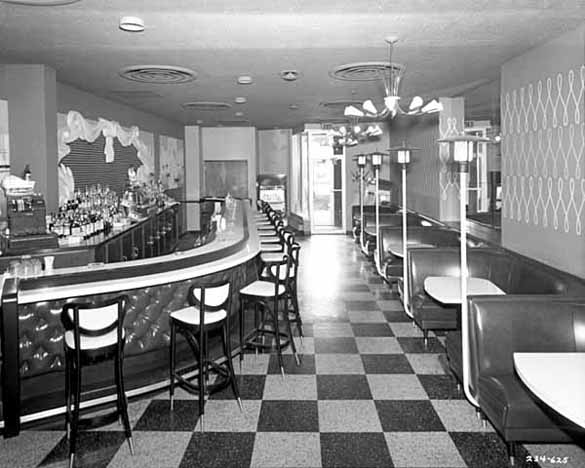
Vic’s in 1955. Photo courtesy Minnesota Historical Society
Other fun facts about Vic: Vic was famous for introducing cheesecake to our fair city, flying it in from Reuben’s in New York daily.
Vic later became a salesman of the Whisp, which was a pressurized spray bottle full of Vermouth for the making of the perfect martini.
OSTERBERG’S SUPPER CLUB
On December 20, 1956, Wilbur C. Osterburg bought the club and the adjacent restaurant, Tiny’s, to create Osterburg’s Supper Club. Osterburg was the president of Peters Oldsmobile, St. Paul. The club opened in April 1957. At first he dropped the jazz entertainment that had been popular at Vic’s.
It operated as a jazz venue from about February 1957 to 1961. The first show was Slapsie Maxie Rosenbloom, from May 6 through 24, 1957. Rosenbloom was a former boxer-turned comedian. The show also featured girl singer Kitty Muldoon, described by Will Jones as “a red-tinted blonde with sparkly teeth.” Although she supposedly worked two days on an Elvis movie – and was dating E at the time – she does not, unfortunately, show up on imdb.com. Also appearing was Keith Gam’s band, with M.C. Bob Franzen.
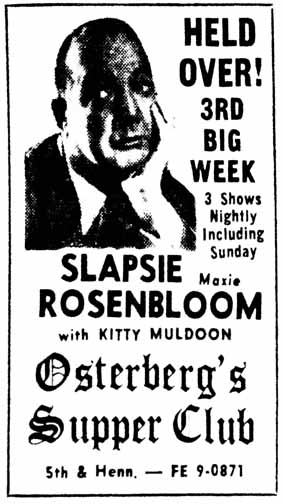
Minneapolis Tribune, May 23, 1957
Rosenbloom was initially hired for the week of May 6 – 12, 1957, but was held over until at least May 24. By May 30, he must have been gone, and Kitty was working solo.

Minneapolis Star, May 30, 1957
By May 27, 1957, Will Osterberg was advertising for a buyer or a full-time manager. He must have found the latter, because the establishment retained his name.
Jazz was back by 1958. A large ad called it “The Most Active, Exciting Nite Spot in the Twin Cities” It denoted “4 Different Rooms to Entertain You:”
- Front Room: Meet your friends here for conversation & companionship.
- Piano Room: Johnny Robertson’s piano styling for group singing.
- Stage Room: Features the most pretty girls from New York to Hollywood.
- Venetian Room: For dining and dancing to Ronnie Neuman’s Orchestra.
“Outstanding Entertainment, Delicious Food, Jazz, Latin-American, and Mood Music, Dancing and Atmosphere You’ll Love.” You could even get a buffet dinner for $1.25 – until 7 pm, at least. (Minneapolis Tribune, January 4, 1958)
Despite the ad below, the Bob Davis Quartet had a fairly long run until they broke up.
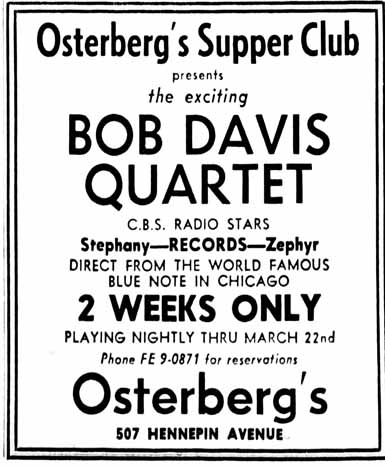
Minneapolis Tribune, March 12, 1958
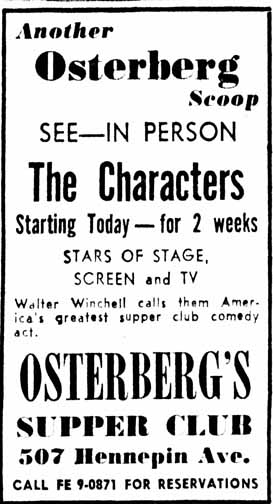
Minneapolis Tribune, April 7, 1958
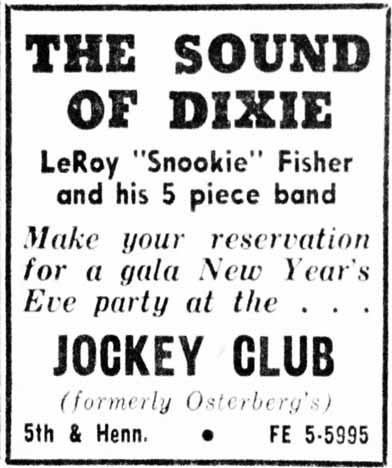
Minneapolis Star, December 23, 1960
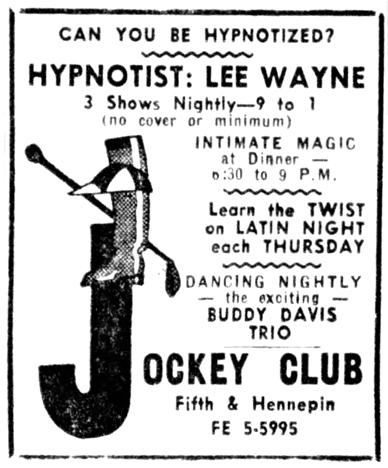
Minneapolis Star, February 22, 1962
SHARI FARRIS Shari Farris was more of a smooth song stylist, not exactly associated with the Twist, but she may have worked the transition or at a piano bar. Another ad says she was still at the Jockey Club on March 22, 1962.
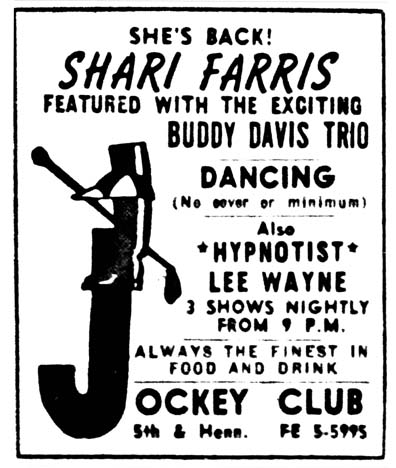
Minneapolis Tribune, February 28, 1962
1962 AND THE TWIST!!
1962 was the Year of the Twist, and here the Jockey Club gives the date when it succumbed to the New All Girl Twist Review Policy – June 26, 1962. These ads came from the Minneapolis Daily Herald, a newspaper that tried to pick up the slack when the Star and Tribune were out on strike in the summer of ’62.
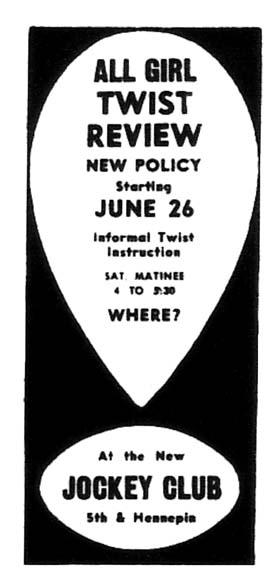
Minneapolis Daily Herald, 1962
Another ad from the Minneapolis Daily Herald revealed that the All Girl Twist Review featured Nikki Cartwright, direct from the Broadway hit, “The Unsinkable Molly Brown;” Christine Joan, “Europe’s Enchanting Twistress;” and the Precisions, from Chicago’s Peppermint Lounge. (June 27, 1962)
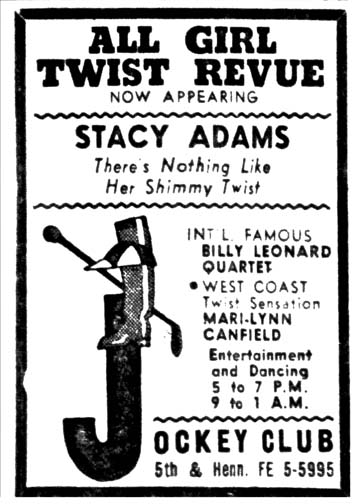
August 16, 1962
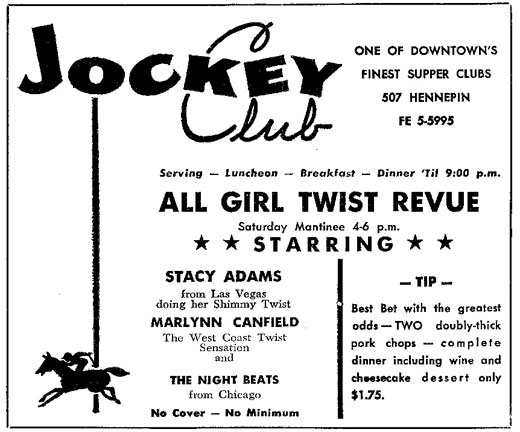
Ad courtesy Gary Myers
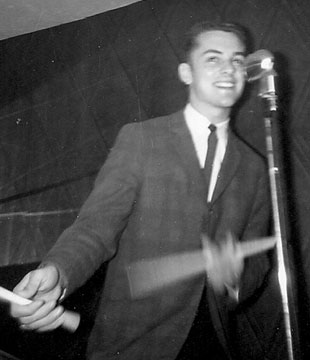
Photo courtesy Gary Myers
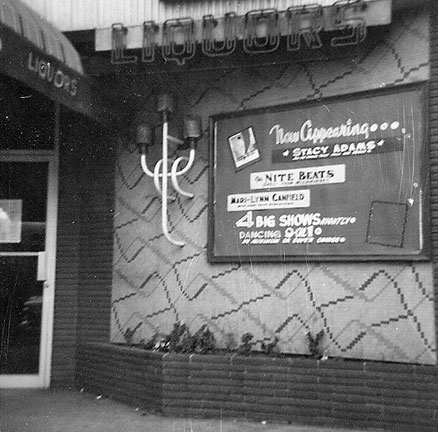
Photo courtesy Gary Myers
Following Gary and the boys was the Twist-A-Rama USA!
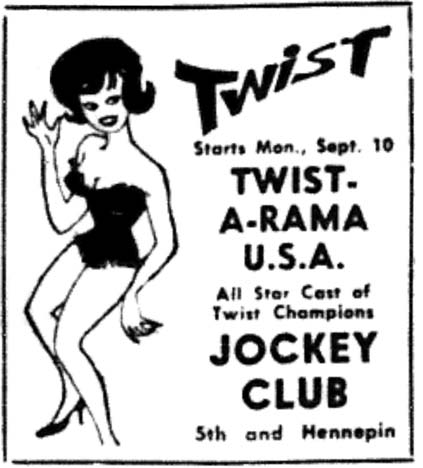
Minneapolis Daily Herald, 1962
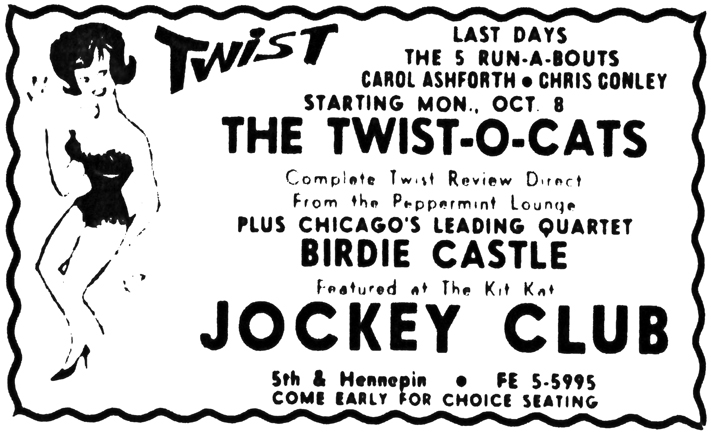
Minneapolis Star, October 5, 1962

December 31, 1962
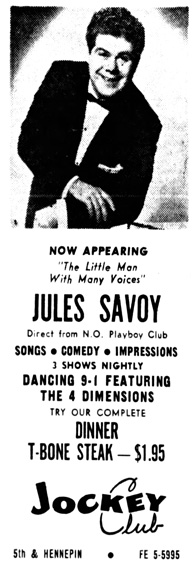
Minneapolis Tribune, January 19, 1963
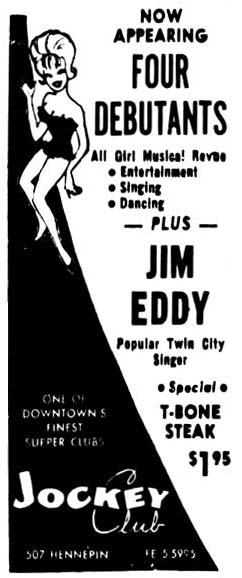
Minneapolis Tribune, February13, 1963
Below is the last ad I found. The “Crystals” aren’t the Crystals at all, but the backup group for Gary Criss. Gary was in a group called the Glass Bottle, which sang “I Ain’t Got Time Anymore” in 1972 that probably only I remember. Kitty Randell doesn’t show up anywhere.
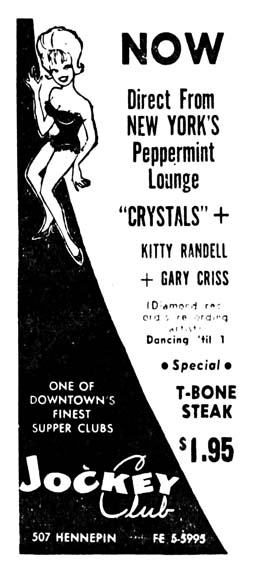
Minneapolis Star, April 19, 1963
A June 1963 ad described a race track decor with the accent on fun and excitement, with Dixieland music and dancing nightly. The Jockey Club ran its last race in September 1963.
ROARING TWENTIES On May 1, 1964, the club became the Roaring Twenties Lounge with Doc Evans’ Dixieland Band providing the music. In 1969 the band was the Norm Berger Orchestra.
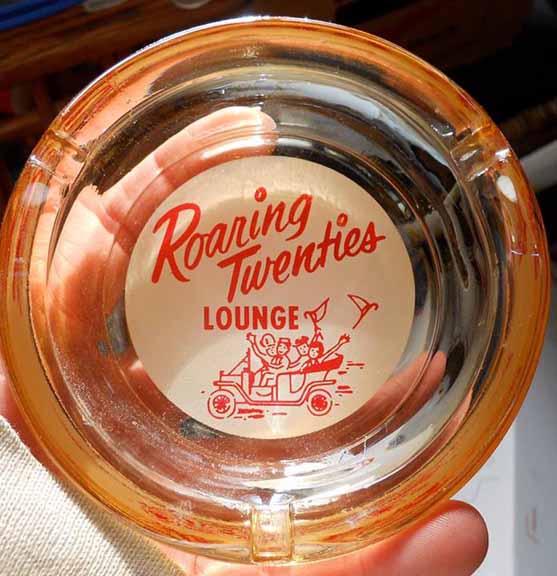
Ashtray from the collection of Mark Youngblood
Matchbook below from the collection of Mark Youngblood:
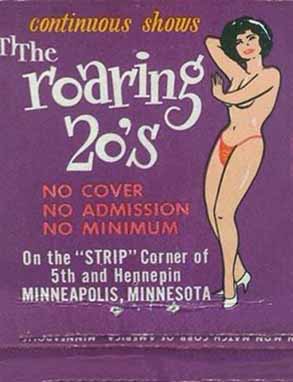
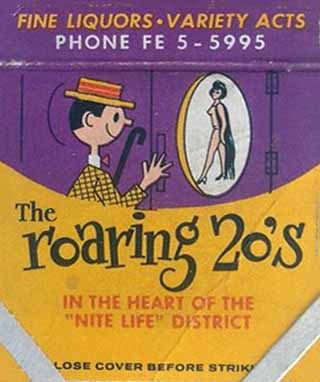
THE ROARING WEST A strange ad appeared in the paper on April 30, 1971, touting a club called The Roaring West, “formerly the Roaring 20’s.” The entertainment was Pat Starr and the Country Gentlemen. Another one appeared on May 1, and the ad on May 6 said that the Leathermen and Marie Babin were coming on May 10. What was that about? Some experiment that anticipated “Urban Cowboy” by ten years? Whatever happened, the club went back to being the good ol’ Roaring 20’s real quick.
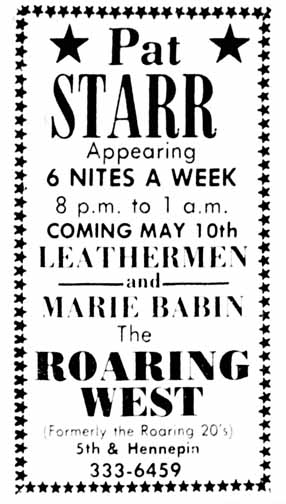
Minneapolis Star, May 6, 1971
There doesn’t seem to be any activity at the address after March 1981. But there’s this online from Curt Anderson:
I was the owner of the Roaring 20’s from 1974 through 1984 when It closed. I was in the 20’s every night for 10 years. After 84 I went on the lam for four years until I was caught in Florida. I went to trial in Minneapolis and received 20 years. I got out in 2000 and am in New York City where I am in business for myself. No – Not the bar business!
A demolition permit was approved for this second Hale Block on March 13, 1986.
West Bank home of Willie Murphy and the Bees, it started featuring live music in the mid-1960s. Owned by Mike Nelson. Closed in August 2006.
720 So. 4th Street, Minneapolis – 1955. This was listed merely as the Labor Hall in December 1941.
Highway 55 in Golden Valley. In the summer of 1963 the Seven Seas Room had a “king sized dance floor” and featured Irv Williams with vocalist Ron Washington.
230 Front Ave., St. Paul, 1971
Vincent VanGogh Go? Really? 211 So. 6th Street, in the Lewis Building, Downtown Minneapolis.
1965-66.
Photo below is a shot of Danny’s Reasons. At right is Ira “Smitty” Smith checking IDs. Photos from Minneapolis Tribune, October 17, 1965.
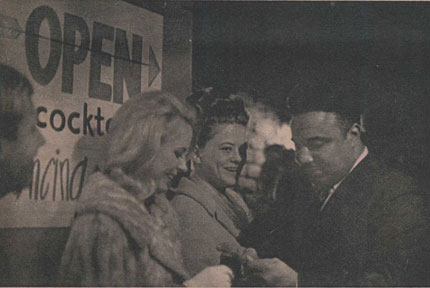
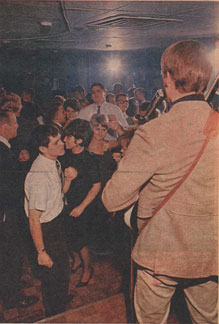
The Lewis Building went up in a huge conflagration on December 11,1966.
One each in Minneapolis and St. Paul, not related.
The Waiters’ and Porters’ Association seemed to move around a lot.
In 1917 it was at 309-311 Hennepin Ave.
In 1930 it was at 718 Sixth Ave. No.
South St. Paul. In 1964 WDGY’s Bill Diehl hosted shows there. It was the venue for a 1967
dance featuring nominees of the first annual Connie Awards. A 1967 list said it it was only open to teens on Fridays.
The Way was a community center on the North Side of Minneapolis created in response to the first riots in August of 1966. (The second wave of riots occurred in July 1967 – click here for info).
A book called Minneapolis Negro Profile edited and published in 1970 by Walter R. Scott, Sr., included these photos that show that it was a live music venue as well. The band below is called the Cassanovas. Caption for the dancers reads: “Dance time at the Way Center and the young ‘brothers’ and ‘sisters’ do the Soulful Strut and get themselves together!”
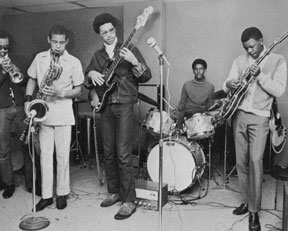
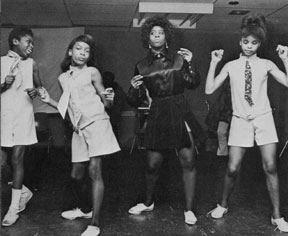
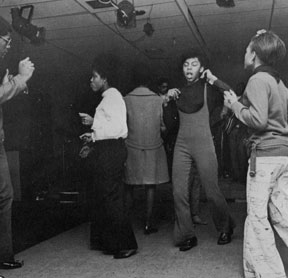
Save
The West St. Paul Armory (there was also a St. Paul Armory) was at 1346 South Robert Street at Emerson.
The earliest mention of the West St. Paul Armory found in the Minneapolis papers was in 1959, where the uses appeared to be boxing matches and political events.
In September 1961, the West St. Paul Fall Festival Dance was held in the Armory.
In April 1965, cots were set up in the Armory to accommodate people who had to evacuate their homes in the wake of the rising Minnesota River. 1965 saw the worst flooding in recent memory.
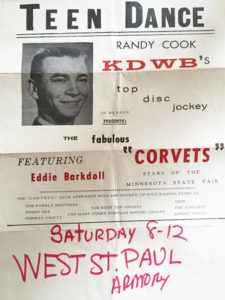
930 So. Robert St., St. Paul.
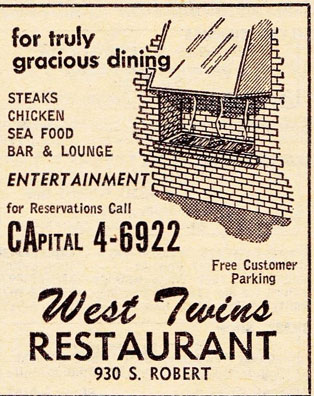
1958
The West Twins Lounge was located on South Robert Street in St. Paul.
Sonny Zarich played at the piano bar.
The Westerner was located at 2925 Hennepin Ave., Minneapolis. Hey, maybe it had a cowboy band!
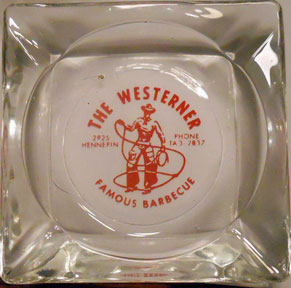
From the collection of Mark Youngblood
Save
Save
St. Paul
1965: Keith Zeller and the Starliners
The Whirlpool Bar? Probably not, but as long as Mark Youngblood has a cool ashtray:
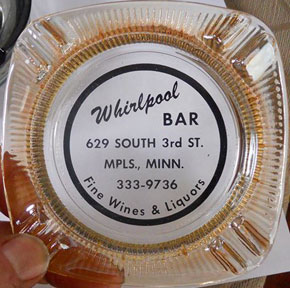
Save
These are some of the entertainment spots located at 435 St. Peter Street in Downtown St. Paul. Thanks to Steve Brunsberg for helping me figure this out!
Located at this address at various times were:
- Chez Rene
- George Willkom’s
- Whiskey Go Go
- Showboat
CHEZ RENE
The Chez Rene Restaurant opened in 1945 by chef Rene A. Boursier. An ad dated October 8, 1950, called it the “newest French Restaurant and Cocktail Lounge in St. Paul.” The address was only given as 7th and St. Peter.
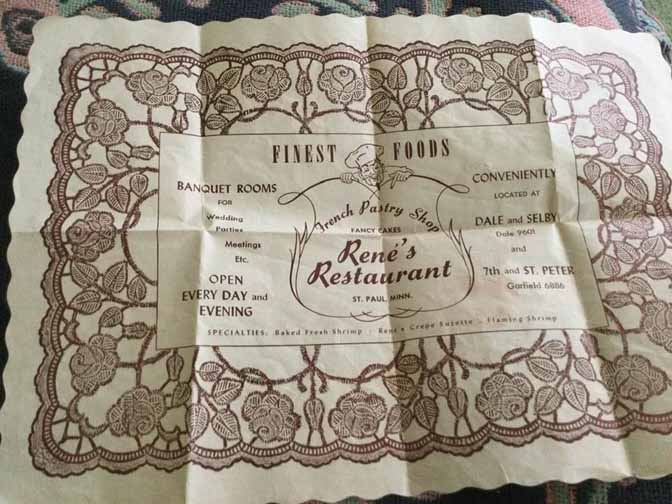
Image courtesy Rosemary Elli Kassekert
On February 9, 1951, fire swept the two-story restaurant, causing losses of $25,000 to $30,000. About 100 lunchtime customers had to be evacuated. The second floor was burned out, and the first floor and basement were damaged by smoke. Some St. Paul firemen had to be called from the 3M Plant. (Minneapolis Star, February 9, 1951)
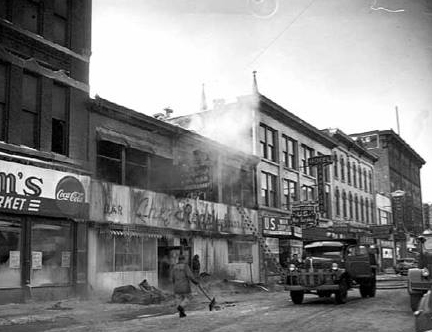
Photo courtesy Minnesota Historical Society
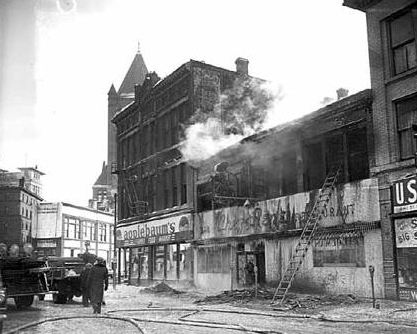
Photo courtesy Minnesota Historical Society
On February 19, 1952, Rene and one of his waitresses were among ten proprietors arrested for selling liquor to a teen-age St. Paul robbery ring. They were released on $200 bail each. They were accused of selling two Tom Collins drinks to a 17 and 18-year-old, who had gone to the restaurant with their dates to “put on the ritz.” It was a celebration of a holdup that had netted them $500. (Minneapolis Tribune, February 20, 1952) Both cases were dismissed.
Boursier died on November 22, 1956, of a heart attack at the age of 53.
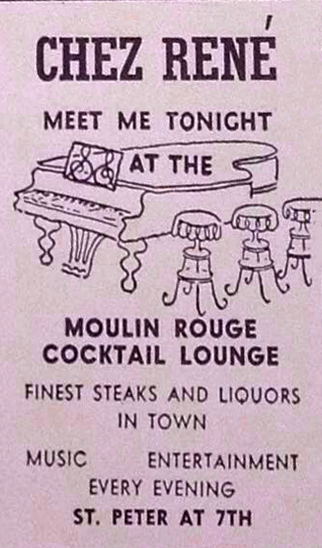
1960 Ad courtesy Mark Youngblood
A “Places to Go” note in some publication from 1960 describes Chez-Rene (with a a dash like that) thusly:
Downtown’s Finest Steak House. Delightful luncheons served from 11 A.M. For your evening’s entertainment, Dorothy Truman, organist in the Main Lounge and Dining Room. Featured in the back room “Allens Alley” is Fabulous Felix Healy. A fine variety of entertainment.
Odd to think of Rene’s fancy French restaurant as a “Steak House.”
GEORGE WILLKOM’S
A Diner’s Club-type ad from May 1963 gives George Willkom’s as the name of the restaurant located at this address.
WHISKEY GO GO
Whiskey Go Go was an over 21 spot that operated here from 1965 to 1967.
Or was it Whisky Go Go? Let’s Google Whisky:
Whether it is whisky or whiskey has been the basis of many arguments over many years. The spelling whisky is generally used for whiskies distilled in Scotland, Canada, Australia, Japan and Europe, while whiskey is used for the spirits distilled in Ireland and America.
The ads below show that the club couldn’t decide either. Which ever it was, it is clear that it was not “Whisky a-Go-Go,” like the club at 8901 Sunset Blvd. in West Hollywood. Just Go Go.
1965 and Go Go Girls
1965 was all about Go Go, with girls in skimpy outfits dancing in cages. The most famous Go Go girl was Lada Edmond, Jr., the girl wearing the fringe in the cage doing the frug on Hullabaloo. The Go Go girls of the Twin Cities were more likely to be college girls or young moms trying to make a buck. Were you a Go Go girl? I would love to hear your story!
The Glass Cage
A 1965 article showed go-go girl Mickey McCann dancing in a glass cage while taking requests for rock ‘n’ roll records from patrons who call from phones around the bar. Are those Hamm’s beer cans on her shirt?? (Minneapolis Tribune Picture Magazine, October 17, 1965)
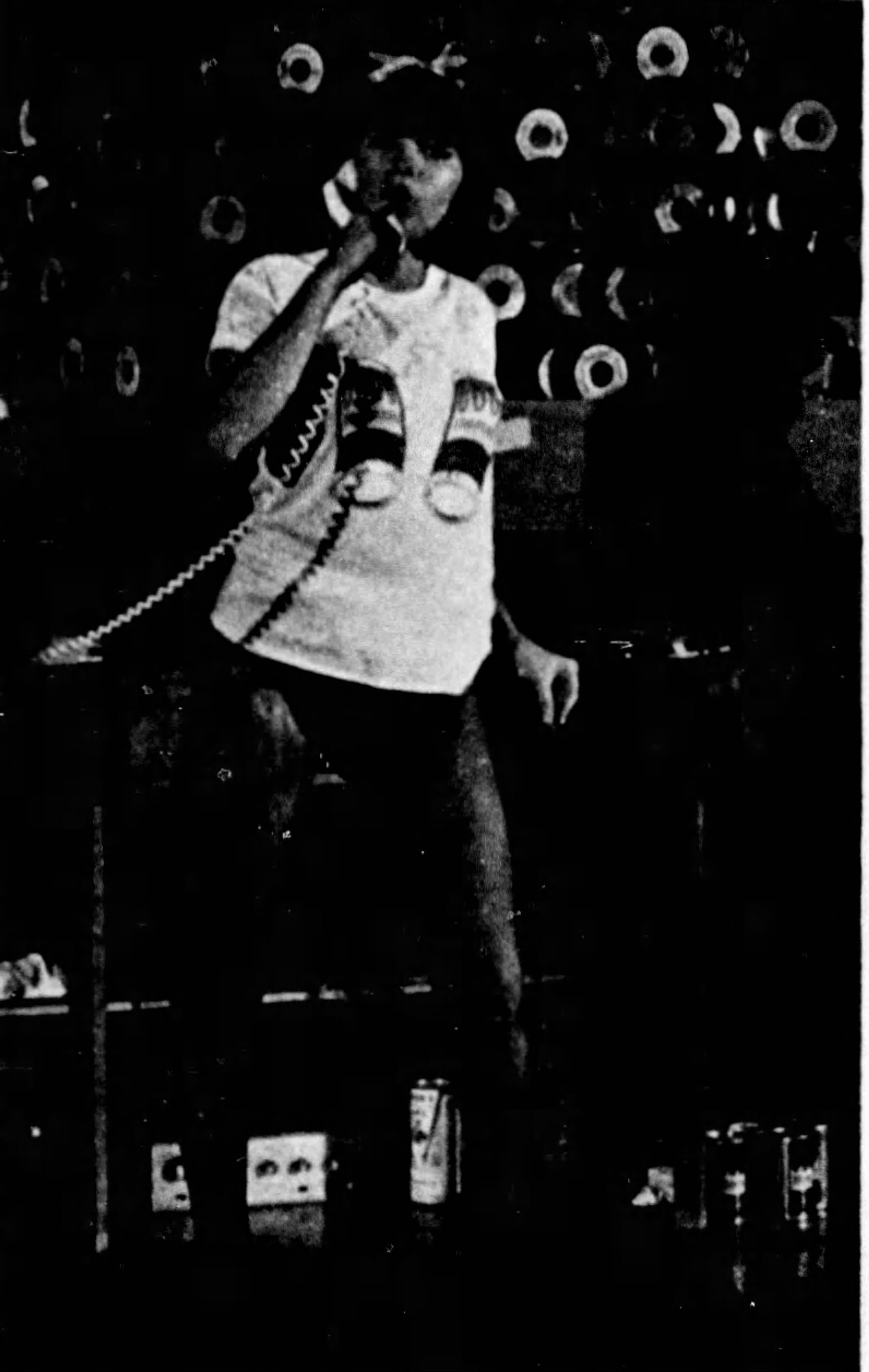
The Whisky Go Go was featured in the Minneapolis Tribune Picture Magazine of January 2, 1966 – in a feature on glass! The caption for the picture below reads:
Go-go girls dance in a glass cage – and take requests for rock ‘n’ roll records from bar patrons – at Whisky Go Go, a combination go-go place, and discotheque on St. Peter St. in downstairs St. Paul. Cheri Marshall [below] works there part time. She’s also a secretary at Anderson Dodge 1201 E. Lake Street, Minneapolis.
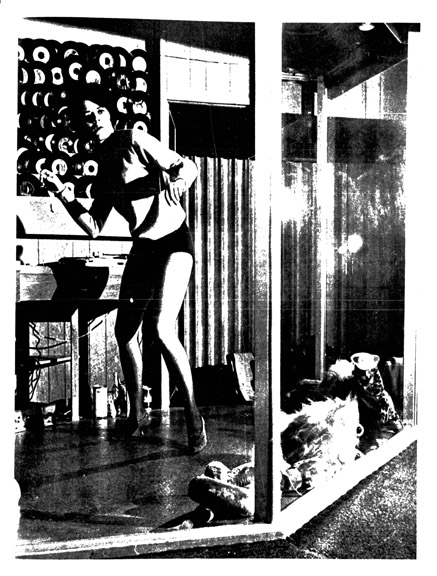
Joey Dee: Week of March 6, 1966
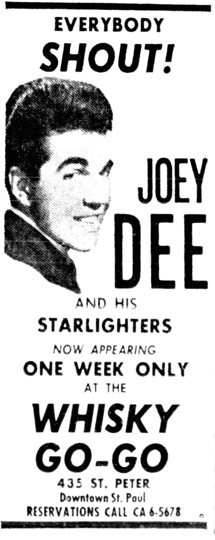
Dee Dee Sharpe: Week of March 13, 1966
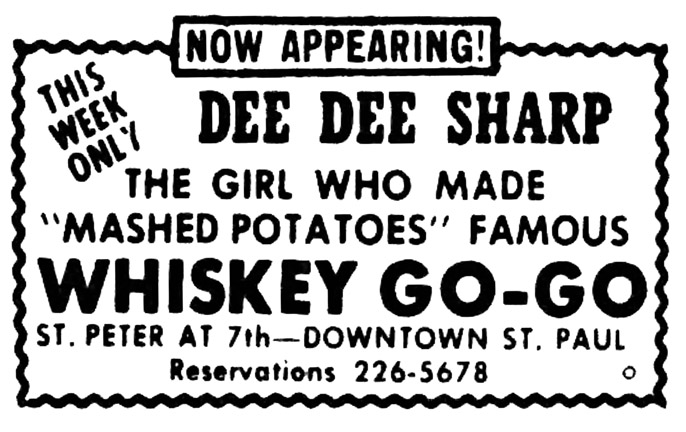
Dick and Dee Dee: Week of March 21, 1966
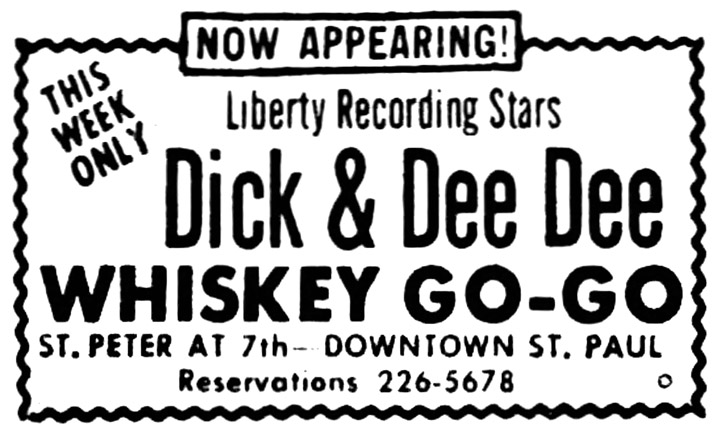
Bill Haley and His Comets: Week of March 27, 1966
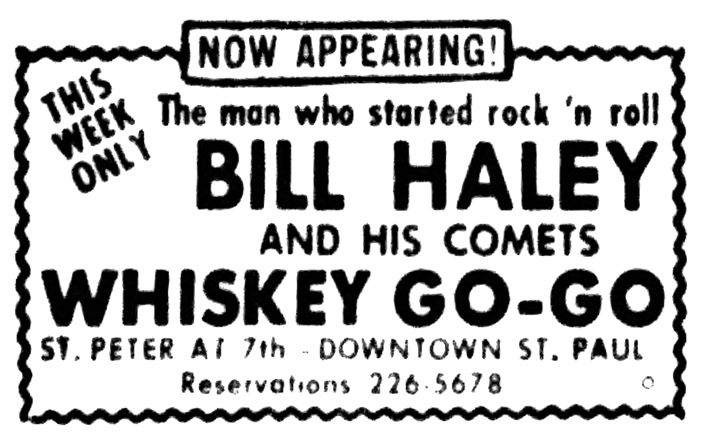
The Chiffons: Week of April 3, 1966
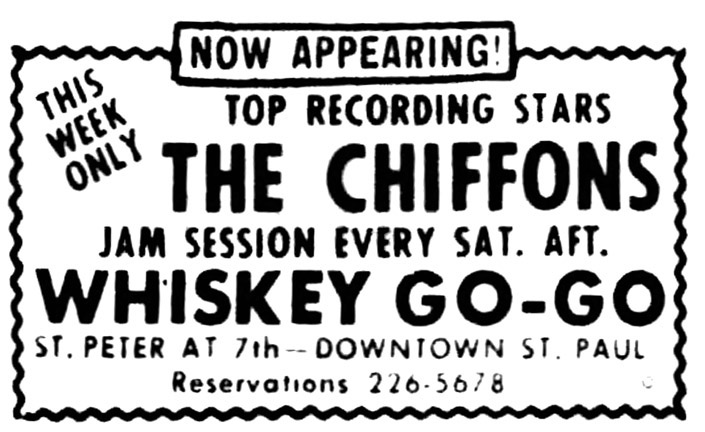
The Crystals: Week of April 10, 1966
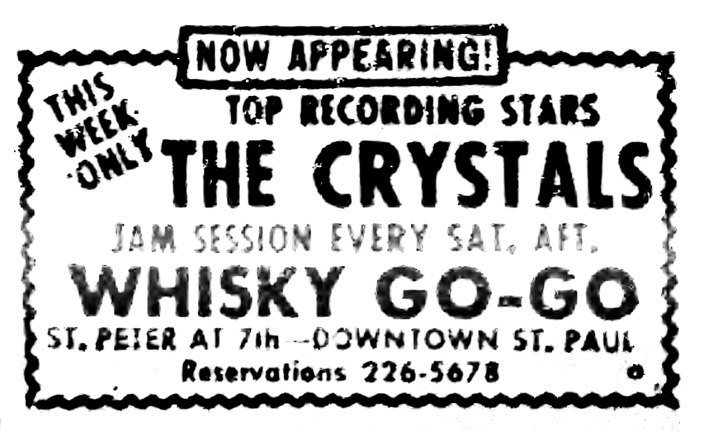
Chubby Checker: Week of May 1, 1966
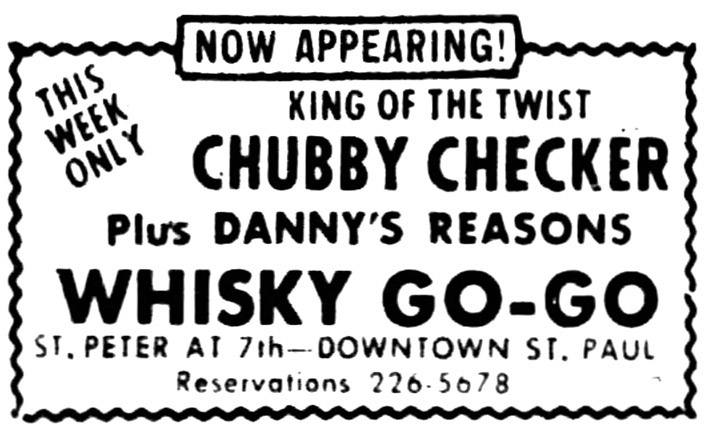
Freddie Cannon: Week of May 8, 1966
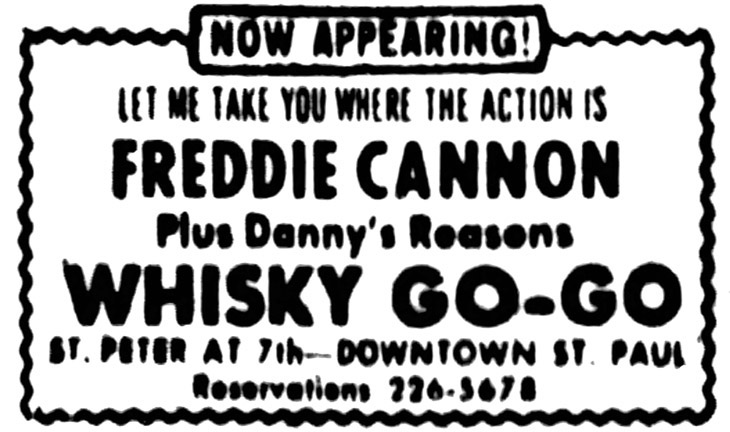
Jr. Walker: Week of June 8, 1966
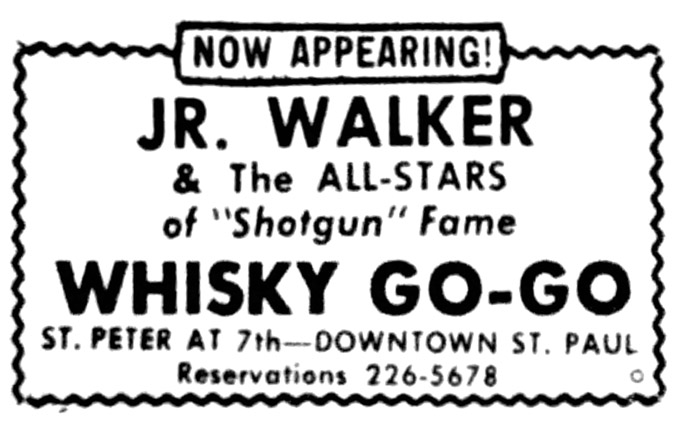
Jerry Lee Lewis: Week of June 22, 1966
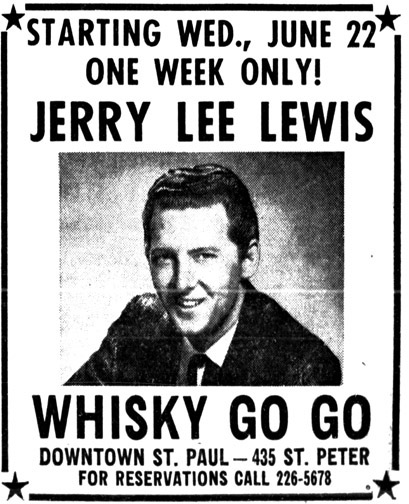
Joey Dee and the Starlighters: Week of July 10, 1966:
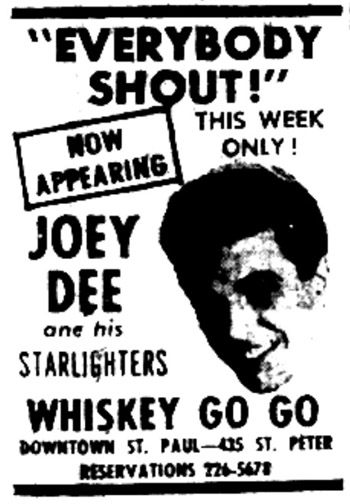
Trashmen: August 15 – 29, 1966, as reported in the Tribune by Will Jones on August 15, 1966.
After mid-1966 there are no more music ads for the Whisky, but there are some scandals to report on.
Assault
On November 30, 1966, Frank J. Belgea, age 23 and identified as the manager of the Whisky Go Go, was fined $100 for assault when he was accused by Gary Gourd of kicking him when ejecting Gourd from the bar. Belgea said Gourd came in drunk, was refused service, fell off a bar stool, and annoyed other customers. Belgea said he “escorted Gourd from the establishment twice but did not kick him.”
Underage Drinking
The next report of bad behavior was in October 1967, when Lt. Ted Fahey of the St. Paul Police vice unit made the recommendation that all of the licenses of the Whisky be revoked because they were serving liquor to minors. This time the owner and operator was identified as Frank Fabio, who had been warned six times since May 1965 about serving liquor to minors and hiring minors as go go dancers and waitresses.
On July 18, 1967, a mother reported that her 14-year-old daughter had been served liquor and had not been questioned about her age. The last straw was on July 20, 1967, when two minor girls were arrested and pleaded guilty of consuming alcohol. The waitress who served them also pleaded guilty and was fined $100.
Listed as the president of the corporation that operated the bar was Richard E. Klein, who was also administrator of Ramsey District Court. Klein said that his family corporation owned the building but that he had never been involved in the running of the bar. Another connection was that the corporation loaned Fabio $5,000 when he bought the property from George Willkom several years ago, and that Klein was still president only because the loan was still outstanding.
SHOWBOAT
According to this fabulous ashtray posted on Facebook by Maureen Flaherty Anderson, the Showboat was owned by Jerry and Al Landreville.
This is not to be confused with the Centennial Showboat, which was an actual boat – paddlewheel – associated with the U of M. It is also not to be confused with the Showboat Lounge, which was in the Holiday Inn in Anoka from about 1973 to 1978.
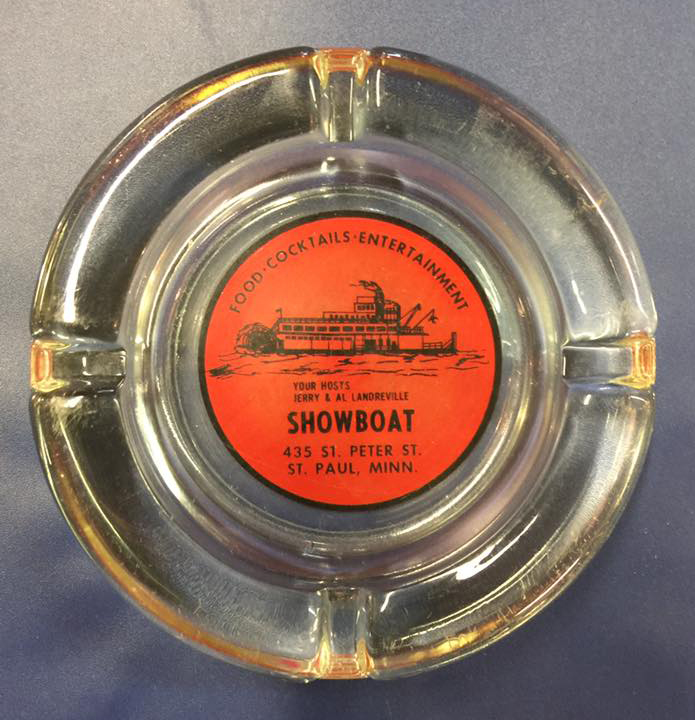
The album below by a group called Deepwater was recorded live at the Showboat, according to the back of the album jacket. No label is given, according to Discogs.com. The group simultaneously released another album, also recorded live at the Showboat. They were originally from Arkansas.
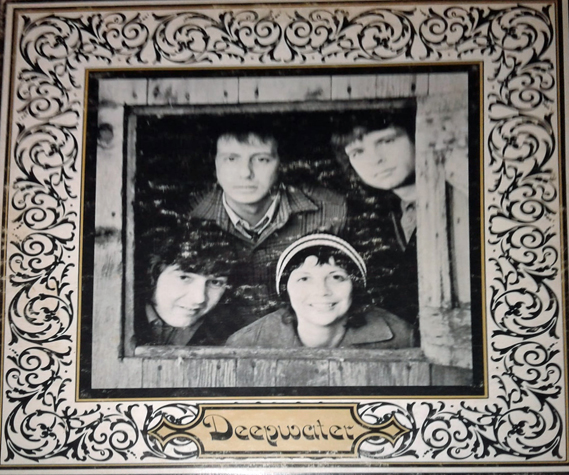
Image courtesy Steve Brunsberg
SHOW’S OVER
The Showboat, described as a tavern, was destroyed by fire on July 18, 1975. The blaze began in the basement and was reported at 3:25 am. Firemen filled the basement with foam. An Applebaum’s Food Market next door had heavy smoke damage. Both buildings were scheduled for demolition later in the year for the realignment of E. 7th Street past the new Civic Center.
Save
Please see Golden Leaf Bar.
2228 4th Street, White Bear Lake.
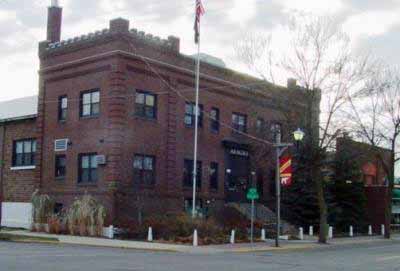
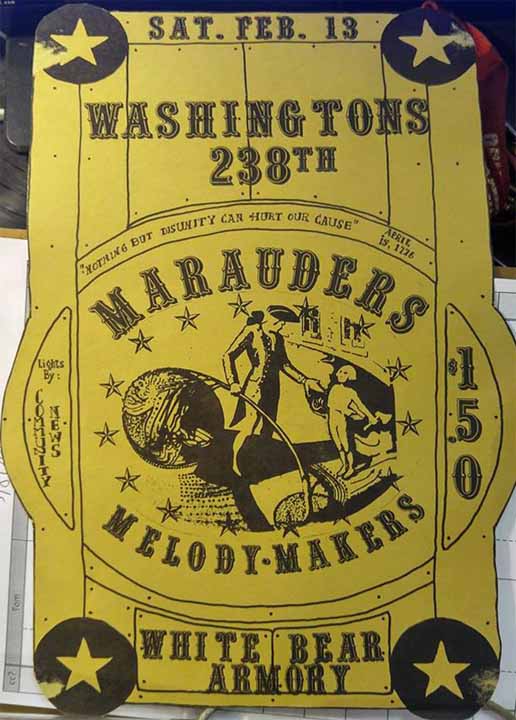
Poster for February 13, 1970, event with the Marauders and White Bear Lake’s own Melody Makers. Courtesy John Kass
The White House was located at 4900 Olson Memorial Highway in Golden Valley. But the early iterations of this club/tavern/roadhouse did not have an address, but were described as being on Sixth Ave. N (which would become Olson Memorial Highway), a mile west of the City Limits of Minneapolis in Golden Valley.
MAX
Max was Max Pallags, who was described as a Golden Valley farmer. In November 1904, he had a tavern (Max Pallag’s Place) at 3100 Western Ave. (later Glenwood Ave.) at Keegan’s Lake (now Wirth Lake), just outside the Minneapolis City Limits. In November 1905, this tavern took great advantage of a new law closing the saloons in Minneapolis on Sundays. An article in the Minneapolis Tribune described him as doing bang-up business. (November 27, 1905.)
Another early bar was on Sixth Ave. N on Keegan’s Lake, owned by J.B. Gilbert. The Tribune reporter said that many people went back and forth between the two Golden Valley bars.
The bars were eventually shut down in December 1909 when the Minneapolis Park Board bought their property for Theodore Wirth Park.
MAX’S PLACE
After he was forced to close down his place on Glenwood and Wirth Lake, Max opened Max’s Place on Sixth Ave. No. Max’s Place was described as a “popular wayside night life haunt.” The question of the day seems to be, when did Max open Max’s Place?
The City of Golden Valley Historic Context Study, issued in December 2020, states that Max built it in 1912.
A 1913 Atlas seems to show that Max’s property was on the south side of Sixth Ave. N., with Sweeny Lake on the other side. That would made the address an odd number, though, and when the place eventually got an actually address, it was 4900.
Legend seems to have it that it has been in situ since 1919.
The first hit on newspapers.com was on August 22, 1928, when Max’s was raided by Federal Dry Agents, who found illegal and faked alcohol. Max and Henry Henning were arrested. (Minneapolis Tribune, August 24, 1928)
In April 1930, Federal Prohibition agents were at Max’s to padlock it for a year, but their final search found alcohol, and they arrested proprietor Max Pallags, who had two prior liquor convictions, and George Link. (Minneapolis Star, April 11, 1930)
An interesting note is that Mrs. Max Pallags had obtained a 3.2 beer license for a tavern in Plymouth in July 1933.
Max died on June 4, 1936, at the age of 68.
FIRE #1
By 1934, Pete Doran had become the proprietor of Max’s Place. Pete and his wife probably lived in the two-story building. The “roadhouse” burned down on April 13, 1934, starting about 4:30 am. Pete and his wife were aroused by Deputy Sheriffs, and Mrs. Doran dragged Pete to safety when he was overcome while battling the flames. The Minneapolis Star showed the wreckage of the place, and also a picture of Mr. and Mrs. Doran. (April 14, 1934)
1935 – 1938
PETE DORAN’S TAVERN
By April 30, 1935, the place was rebuilt – Golden Valley’s report says by Pete Doran and Jack Ennis. It was now called Pete Doran’s Tavern. Pete advertised the place up for sale in May 1938, saying the seating capacity of the place was over 400!
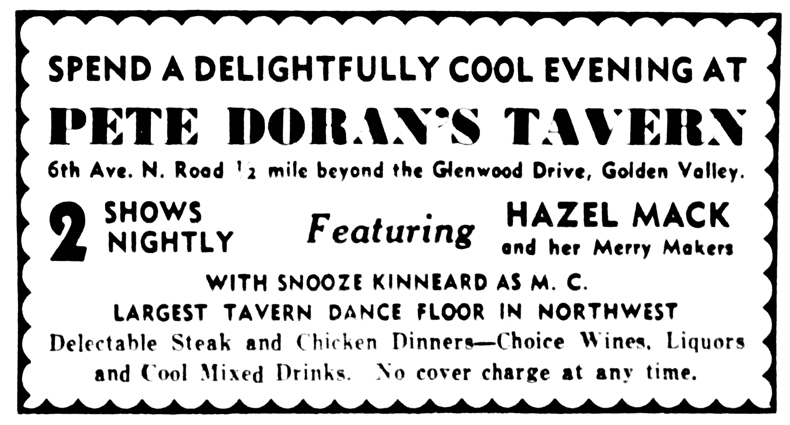
Minneapolis Tribune, July 31, 1936
JOHNNY DORAN’S TOWN AND COUNTRY CLUB
This was not to be confused with the much more well-known Town and Country Club in St. Paul.
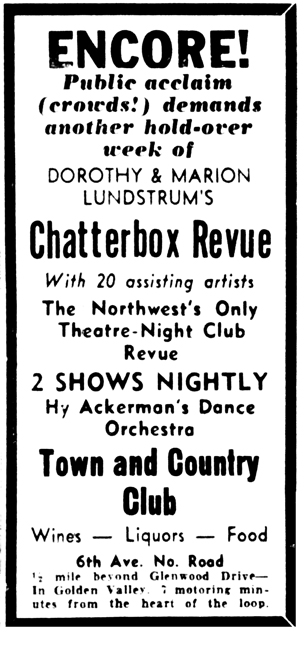
Minneapolis Tribune, February 21, 1939
Below is one of a few ads that say Johnny Doran’s Town and Country Club; the others in 1939 on February 18, August 6, 1939, and October 1 seem random.
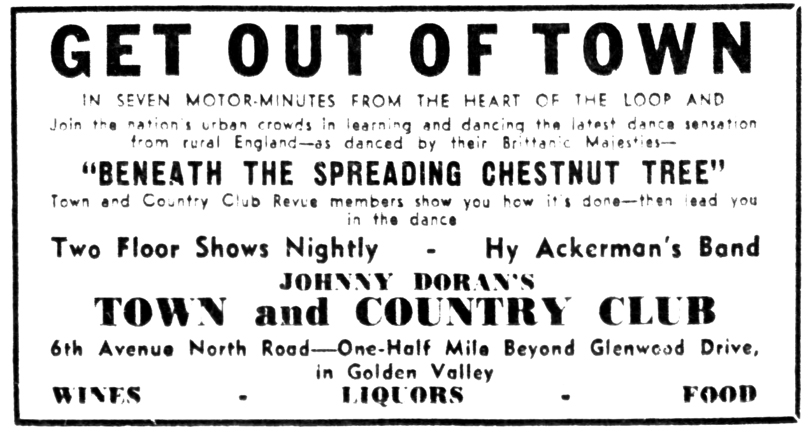
Minneapolis Tribune, April 22, 1939
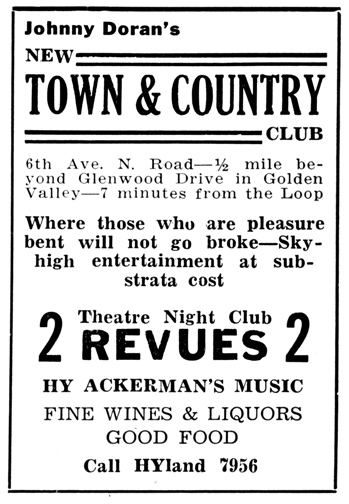
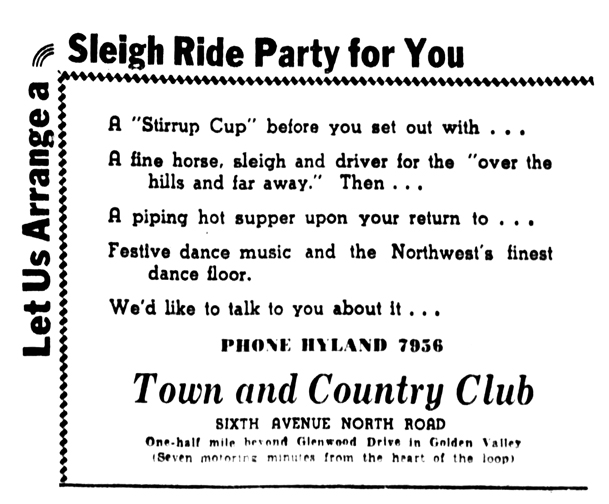
Minneapolis Tribune, January 13, 1940
The ad below is the last Town & Country Club ad I found. Not sure why this says watch for Grand Opening:
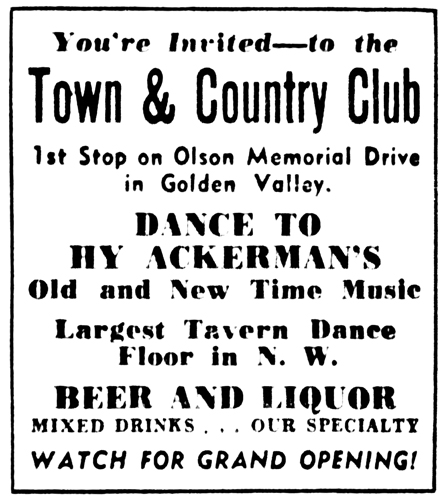
Minneapolis Tribune, June 9, 1940
1940 – 1943
THE TURF CLUB
Again, this is not to be confused with the Turf Club on University Ave. in St. Paul.
The first ad for the Turf Club was found in June 1940.
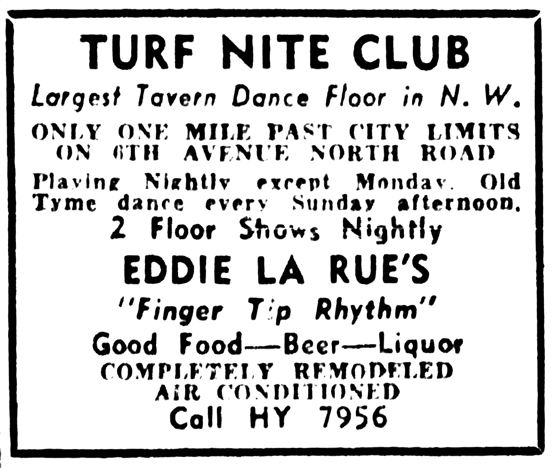
Minneapolis Tribune, June 26, 1940
In October 1941 the Turf Club was advertised for sale, and was said to seat 500 people!
Norm Garvey was the manager, and Vic Lessine the orchestra leader in 1942.
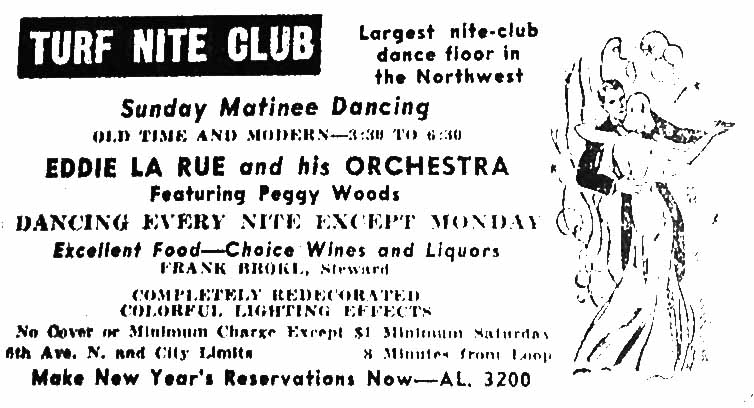
December 22, 1941: courtesy Mark Youngblood
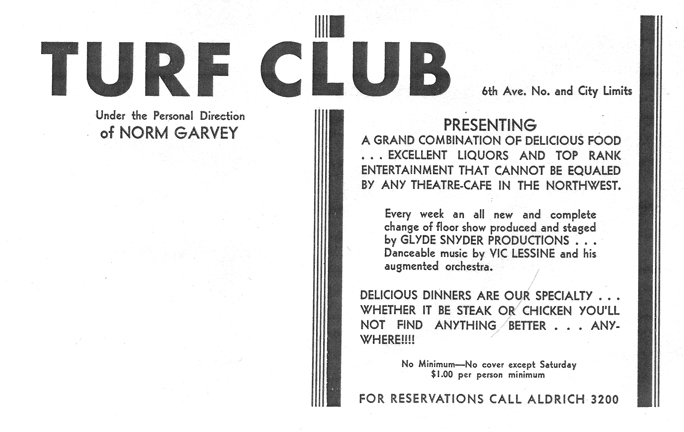
Ad from 1942 St. Louis Park Directory
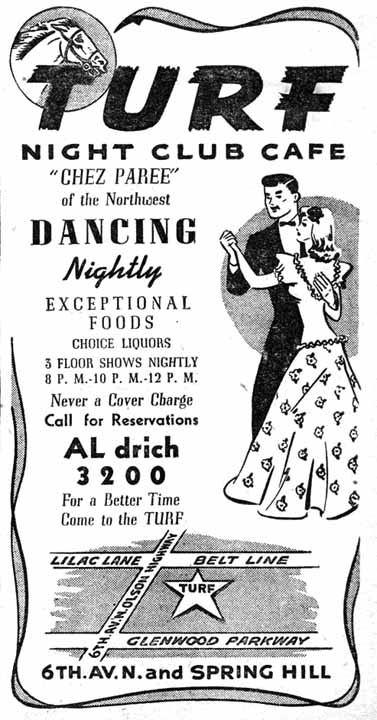
From the 1942 Minneapolis Yellow Pages, courtesy Allen Noble
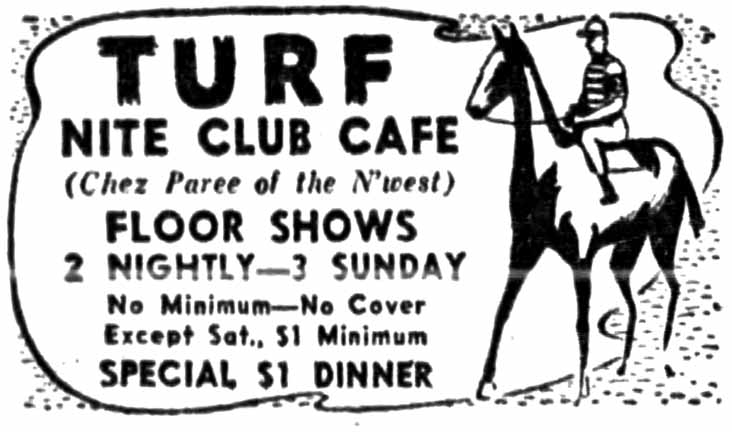
Minneapolis Star, June 19, 1942
This was the last ad that came up under Turf Nite Club: January 1, 1943.
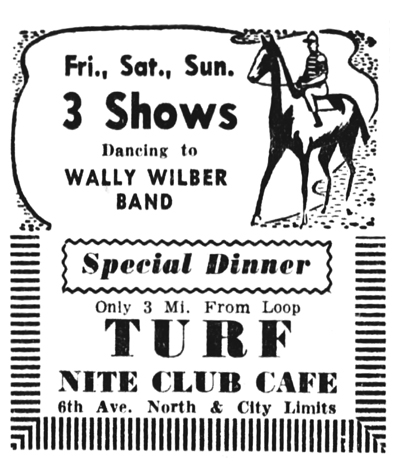
Minneapolis Star, January 1, 1943
Below: priceless souvenir of the Turf Club from the collection of Mark Youngblood.


In June 1943 the owner advertised to sell the club, calling it the “Finest nightclub on outskirts of North Minneapolis.”
1943 – 1949
THE SHAMROCK INN
By August 14, 1943, Jack Radisch owned the bar, which he renamed the Shamrock. Not that there weren’t a million other Shamrock Bars in town! Radisch claimed “We Are Known For Good Food” and promised dancing every night. They played no favorites, advertising in Our Time, an organ of the Hennepin County Farmer-Labor Party and the Republican Register.
The ad below is the only one I found. There was a War on.
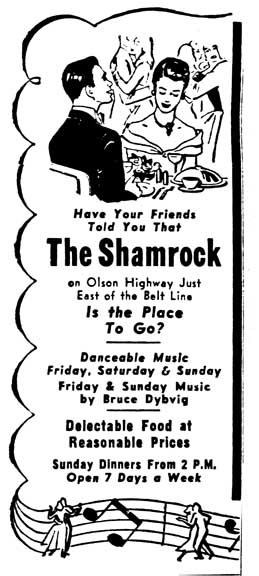
Minneapolis Tribune, August 28, 1949
On August 15, 1949, the liquor license of the Shamrock Bar, 3834 Olson Highway, was transferred to Douglas M. Larson. Doug Larson changed the name to the White House. The Golden Valley report says that it was so named because of its its all-white décor, including the long, white bar.
1949
THE WHITE HOUSE
The first ad under the new name, published on December 10, 1949, said that the place had been “newly decorated.”

Minneapolis Tribune, December 10, 1949
1951
Compared to what it became, the photo below shows that the White House in 1951 was not much to look at, at least on the outside.
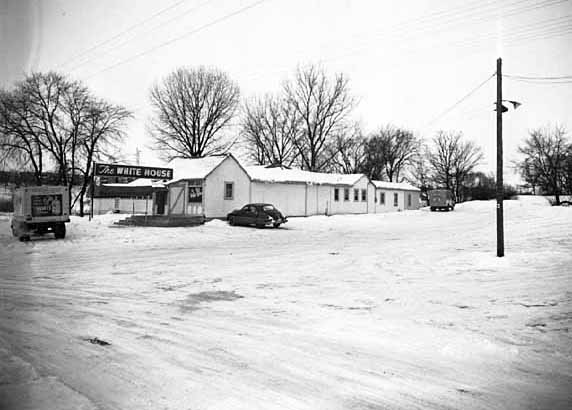
The White House, January 31, 1951. Photo courtesy Minnesota Historical Society
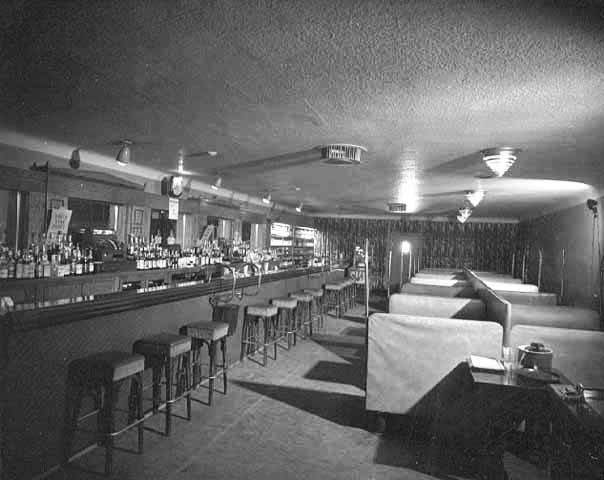
White House Bar, January 31, 1951. Photo courtesy Minnesota Historical Society
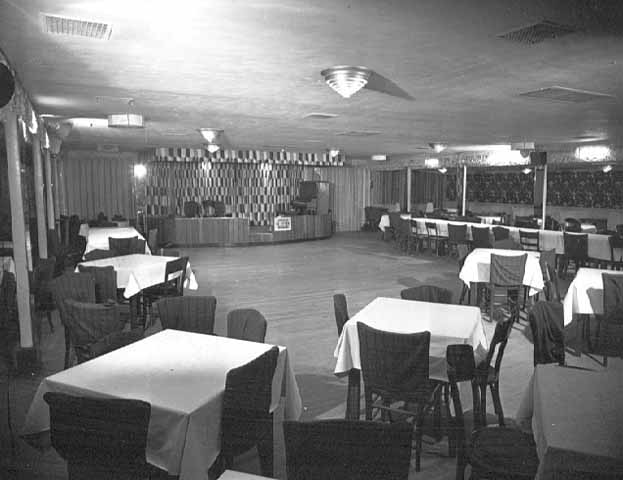
White House Bandstand and Dance Floor, January 31, 1951. Photo courtesy Minnesota Historical Society
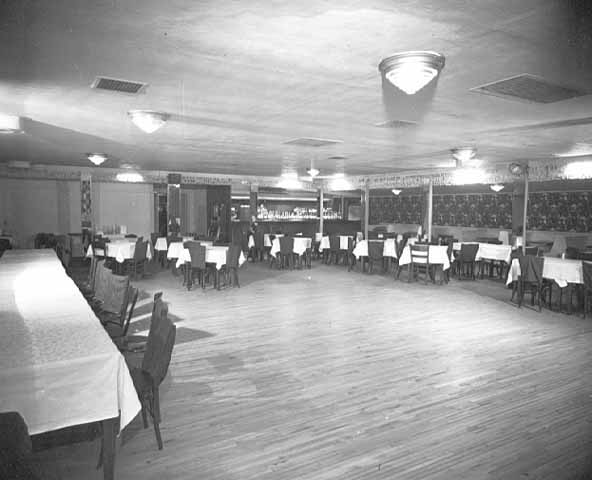
White House Dance Floor, January 31, 1951. Photo courtesy Minnesota Historical Society
1952
MIKE TROUP
On February 5, 1952, the liquor license held by Douglas Nelson was transferred to the newly-formed Tee-Vee, corporation, owned by Maher J. “Mike” Troup and Victor D. Levine. Troup was the owner of a gas station in North Minneapolis and a WW II Veteran. Levine was the son of Vic Levine who owned Vic’s Theatre Lounge on Hennepin Ave.
There had apparently had been problems at the White House, as the Golden Valley Council warned him not to bring the Village any notoriety. The White House was arrears in its taxes and owed $1,700 to its employees, which Troup promised to pay. (Minneapolis Tribune, February 6, 1952)
On October 13, 1952, the Pete Cavanaugh Trio with Rona Rae opened for a two-week stay.
1953
FIRE #2
Damage estimated at $60,000 was incurred in a fire on January 12, 1953. Despite the assistance of the Crystal and St. Louis Park Fire Departments, a lack of water deterred their efforts, and the building burned to the ground.
The blaze was reported at 1:32 am. The liquor store was saved, but only the front wall of the restaurant was left standing. Defective wiring was deemed to be the cause of the fire. (Minneapolis Star, January 12, 1953)
The restaurant was rebuilt at an estimated cost of $144,000.
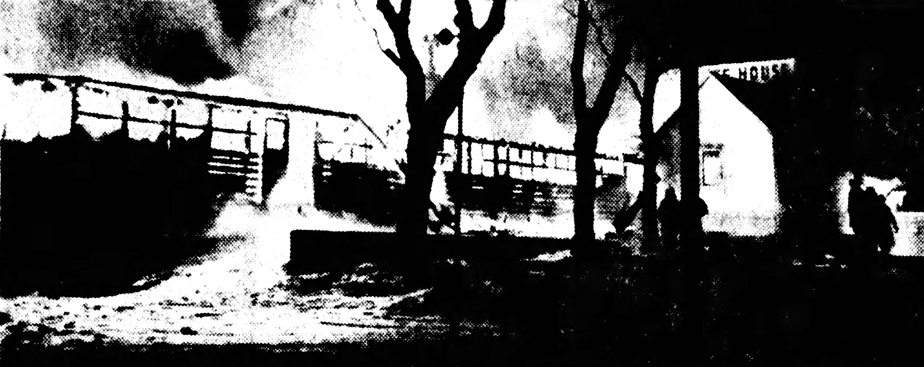
The White House, burned to the ground in 1953. Minneapolis Tribune
SUNNY JIM
If you can believe the report of “Sunny Jim,” the Golden Guernsey Kid, who somehow had his own gossip column, the White House was completely rebuilt and redecorated” and is really loaded with that stuff that call atmosphere.” He described Mike Troup as the sole owner and proprietor – perhaps Levine stepped out of Tee-Vee (are we really taking the word of a child in a Sunny Jim hat?)
Golly! The whole thing was decorated in an Oriental style with just a touch of modernism… The lights are sorta Japanese lanterns except that they’re bigger and are all different colors. There is a 70-foot long window made of thermo-pane that looks out onto a beautiful garden.
The Bamboo Lounge is one of the quaintest things I have ever seen. There are bamboo bird cages hanging from the ceiling and the chairs are built very low… All the lights are very low in this room and there is an air of intimacy about the place. Downstairs there is a room they call the Dragon Room, for private parties for six to 160 people.
Finally, Sunny Jim tells us that the food is prepared and served under the personal supervision of Charles Woo, who was the manager of John’s (a famous Chinese restaurant) for about 30 years. Thank you, Sunny Jim. Or whoever you are. (Minneapolis Tribune, October 20, 1953)
1954
FIRE #3
For the second time in 15 months, fire swept through the White House on Sunday, April 4, 1954.
Two firemen were sent to General Hospital for smoke inhalation, while 12 others were treated at the scene. Firemen from five other suburban departments were called in to assist Golden Valley: Crystal, Hopkins, Richfield, Bloomington, and St. Louis Park. A Hennepin County Sheriff’s Office rescue squad crew helped revive the firemen at the scene.
The fire was first discovered at about 5:15 am by two porters who were cleaning near the front of the club. The fire took five hours to extinguish, exacerbated by plastic covered furnishings that gave off heavy, acric smoke. The fire was believed to have started in the rear of the basement.
Damages ran to $175,000, including $50,000 in liquor. Proprietor Mike Troup said that the loss was almost total and only partially covered by insurance.
(Minneapolis Star and Tribune, April 5, 1954)
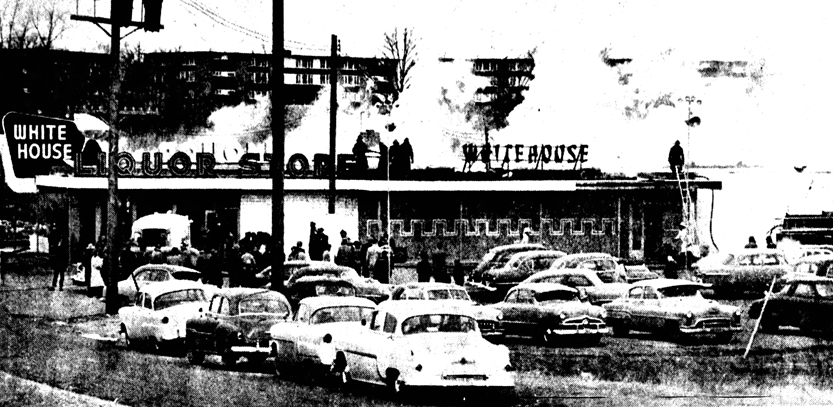
The White House on fire again, Minneapolis Tribune, April 5, 1954. Photo by Jack Gillis
ROOMS IN THE CLUB
The club was rebuilt, this time for the last time. Perhaps this is a good time to try to sort out the different rooms of the White House. This is a stab in the dark, so if you have additions or corrections, please contact me!
THE MAIN DINING ROOM
This room had the bandstand and the large dance floor. Was this what they were, by 1962, calling the Garden Dining Room?
THE BAMBOO ROOM
This intimate cocktail lounge at the rear of the club (next to the Main Dining Room) goes back to at least 1953. It featured a “romantic Polynesian atmosphere.”
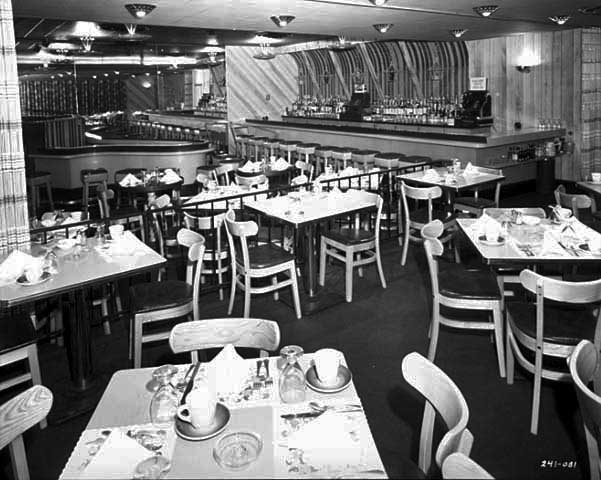
Bamboo Room, October 24, 1956. Photo courtesy Minnesota Historical Society
NOB HILL
On November 7, 1969, Don Morrison of the Minneapolis Star wrote a column about how the White House was replacing the “ticky-tacky Tahitian motif that characterized the old Bamboo Room for years” with “a singularly elegant lash-up called the Nob Hill.” Owner Irv Schectman brought in a team of San Francisco architects to redesign the first floor rooms around their standing walls. The main room was redecorated into a gas-lit 1890s mode. Etched glass windows form a divider between the main dining room and Nob Hill. Deep, curving banquettes, upholstered in red leather line the walls. Object d’art from San Francisco junk and antique shops decorated walls and ledges.
Nob Hill offered quiet entertainment – in November 1969, Augie Garcia was doing his solo act on flamenco guitar.
FRONT LOUNGE
Taking a chance here. A February 1960 ad talks about a cozy Front Lounge. Wondering if this turned into the….
COCK AND BULL LOUNGE
In the dizzying changes in room names, we find the Cock and Bull Lounge from at least June 1962 to 1964. It had an “elegant 1890s decor.” Ragtime Charlie played a 130-year-old piano – now that’s a piano bar! Where it was in the building is unclear.
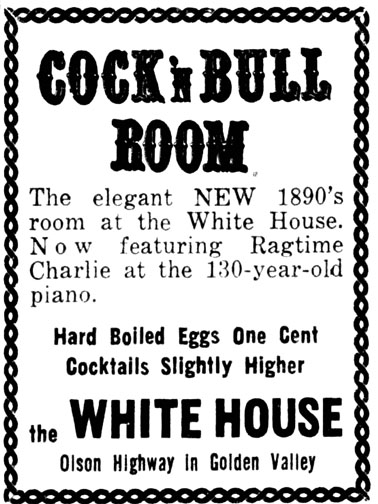
Minneapolis Star, January 25, 1963
THE APARTMENT
This was a cocktail lounge in the basement of the club that, in 1953, was called the DRAGON ROOM.
In about 1962 it was transformed into THE APARTMENT, a members-only key club with “small instrumental combos or female vocalists in low cut gowns” [who don’t] “conflict with intimate cocktail conversations.” The waitresses were called Bambi Girls.
In 1964, advertising copy read, “Don’t miss tonight’s cocktail party – you’ll be pleasantly shocked!” The Apartment also featured a bikini fashion show. It may have featured even more than that, given this naughty ashtray:
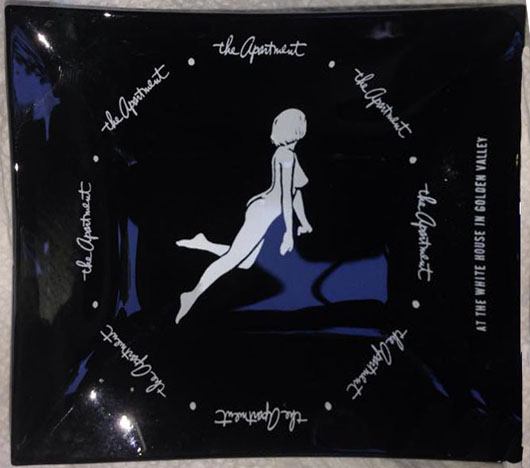
From the collection of Mark Youngblood
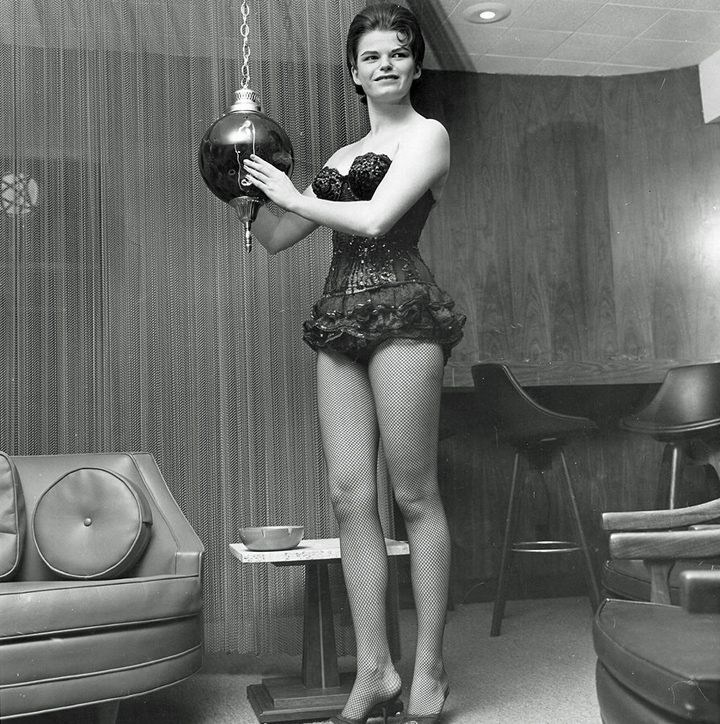
Then there’s this little outfit…
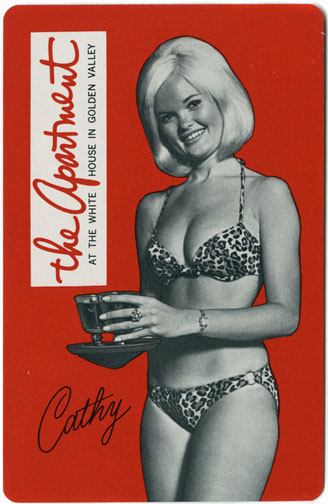
Souvenir playing cards – image courtesy Minnesota Historical Society
THE LIBRARY
The key club concept must have gone by the wayside in the Apartment by 1972, because it was revived for a new room within the Apartment called the Library in April 1972. Membership to the Library was $10 a year or $20 for a life membership. The Library featured:
- A solid wall lined with books contributed by the membership
- A genuine fireplace
- Built-in color TV
- A magnificent oval marble dining table for eight
- Home size bar
- Game table handcrafted from the hatchcover of the S.S. Ernie Pile Liberty ship, recently removed from the U.S. Naval Service
- Contemporary chess and checker sets
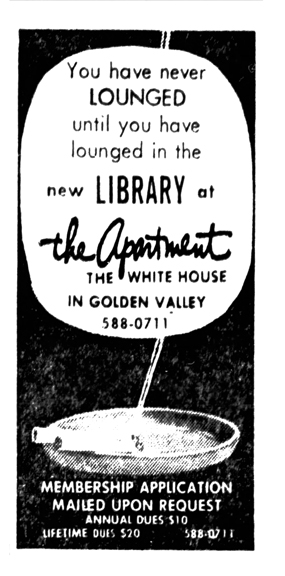
Minneapolis Tribune, July 16, 1972
Back to our Chronology:
1956
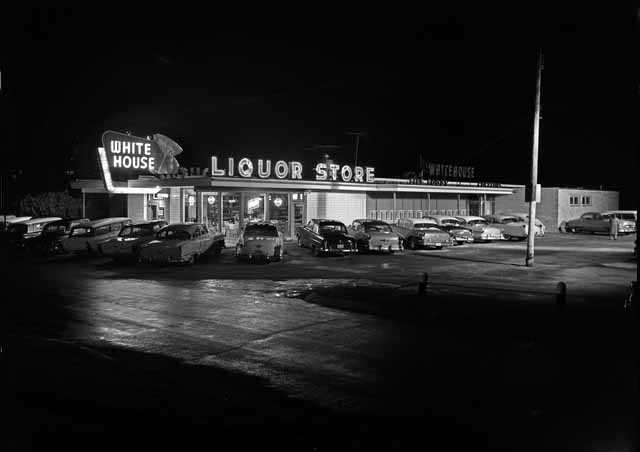
White House, September 14, 1956. Photo courtesy Minnesota Historical Society
RACIAL DISCRIMINATION
On October 1, 1956, two black men and two black women came to the White House at about 11:30 pm and were not allowed to be seated, despite the fact that there were several empty tables. Although some of them had been there before, they were told that Hadda Brooks, the black pianist and singer providing the entertainment that night, “does not care to perform to a mixed audience.” One of the couples, Douglas and Jacqueline Thompson, filed a civil suit in Hennepin County District Court against owner Mike Troup for $500 each plus costs, for their “humiliation, embarrassment and inconvenience.” The sum was the maximum permitted under Minnesota’s anti-discrimination statute.
In 1959 the Minneapolis Spokesman reported that the couple received damages.
1960
IRV SCHECHTMAN
In April 1960, Mike Troup sold the club to businessman Irv Schectman. Troup died in 1964 at the age of 47.
From Schectman’s obituary in the StarTribune, September 29, 2003:
Schectman’s early business was rugs, first as a partner in Minnetonka Rug Mills, which made cotton throw rugs, and then with the Chenille Rug Co., which made room-sized rugs woven on looms. The factory could only make so many rugs a year, and Schectman, who traveled the country selling them, often sold out the factory’s production in nine or 10 months so he could spend most of the summer at home, where he loved to golf. Cheaper tufted rugs made in the South made it unwise to stick with Chenille.
Irv’s son Paul adds:
He and his partners shut down their carpet manufacturing mill based in Minnesota in the late ’50s. My father did not want to move our family down to Dalton, Georgia, where the manufacturing needed to be done in order to be viable. My father and mother refused to raise our family in the racist south. For that I am most grateful.
He turned the White House (a dump of a restaurant at the time of purchase) into one of the top three gourmet restaurants in Minneapolis. (including Harry’s and Charlie’s). The restaurant earned a 4 Star Mobil rating, but my father refused, saying that it only deserved 3 stars.
To its existing Chinese menu he added familiar tomato-based Italian dishes.
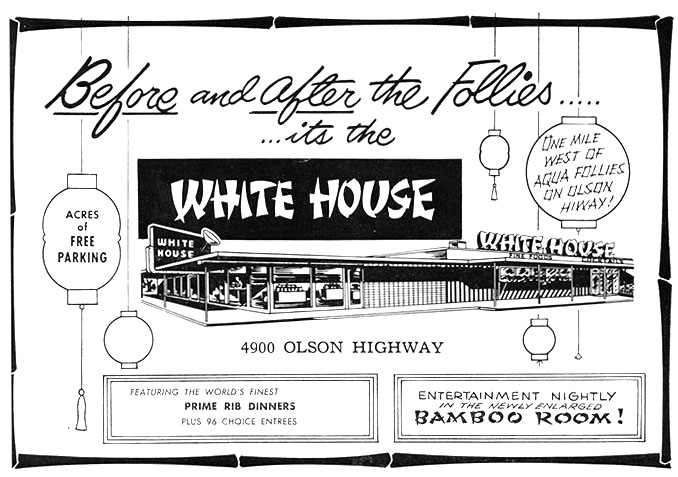
Ad from Aquafollies program, Summer 1960
1962
The Minneapolis Daily Herald took over for the striking Minneapolis Star and Tribune in the summer of 1962. Night Beat reporter Vic Burton described how Toni Lee Scott was rotating between the Bamboo Room and the Apartment, which was apparently a common practice. (May 4, 1962)
ICE SHOW
Burton also described the miniature 40-minute ice show in the new outdoor garden. Tables were set up around a 10′ by 12′ rink, and dinner was served rinkside. Three shows were given each night plus a Saturday matinee.
The month-long (approx. June 20 to July 20) The 1962 show of precision skating featured:
- Robin Nelson
- Gladys Jacobs, 1956 U.S. figure skating champion
- “Venita,” a skater from Columbia
- Nancy Emerson, a local girl making her professional debut
Owner Schectman’s son Paul described these shows as:
Professional Ice Capades-quality shows performed outside in the rose gardens for several years during the sweltering summers. The performers had to skate quickly!
Schectman himself quipped that “if a June outdoor ice show proves to be a hit, he’s all set to sponsor an outdoor aqua show in January.” (Minneapolis Daily Herald, June 14, 1962)
1963
The “Career Girl Dinner” came with a choice of three entrees and an after-dinner cocktail, all for $1.95!
Will Jones reported that Irv bought 100 portable charcoal grills for the customers to use at their tables in the outdoor gardens. “On Saturday nights, waitresses will bring the menu to the table in the raw: a tray of assorted steaks and ground concoctions, already marinated and seasoned. Diners will select their dinners and cook them themselves. It’s a one-price deal $3.50 for the complete dinner. If a lazy soul asks to have his meat cooked inside by a chef, that can be done, too, but the price goes up to $4.50.” Wonder how that went over.
Entertainment included Geordie Hormel’s new quartet, the Dick Burgess Trio, with vocalists Rosalee Brown & Dave Brown, and Monette Malvar, the former lead in the Flower Drum Song. Four shows nightly.
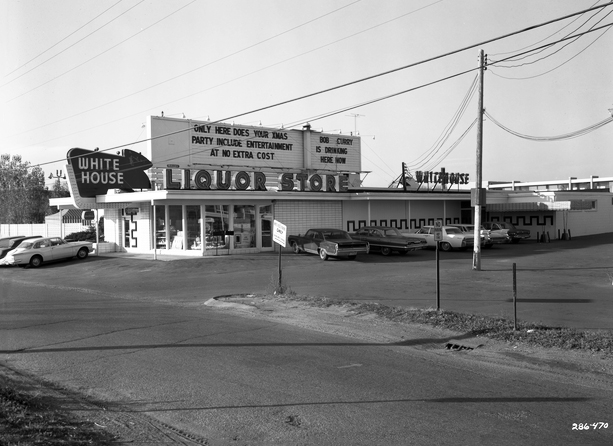
White House, 1963. Photo courtesy Minnesota Historical Society
THE SIXTIES
These were big, fun years at the White House. Son Paul describes some of the action:
My father arranged for Helicopters to fly patrons from the large back parking lot to numerous Vikings games. Buses were regularly scheduled to Minnesota Gopher games. During the ’60s my father arranged numerous junkets for patrons and friends to Las Vegas, Hawaii, and Mexico.
One such trip was a four day trip to Las Vegas in March 1967.
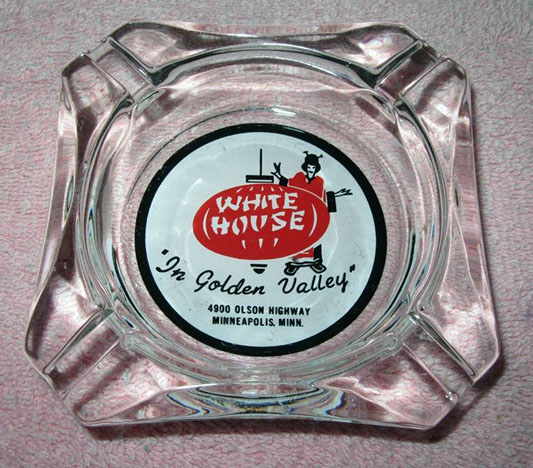
From the collection of Mark Youngblood
An undated flier provided by performer Tom Prin states that:
During the 1960s, Apartment members were privileged to see and hear over 200 star talents such as Jose Feliciano, Sergio Mendes and Brasil 66, Charlie Byrd, Jackie Cain and Roy Kral, Buddy De Franco, Cal Tjader, Big Tiny Little, and so many others. There is a resurgence of better music coming to the fore now and we have quadrupled our budget to present the very best talent.
1964
The White House had already become a jazz venue.
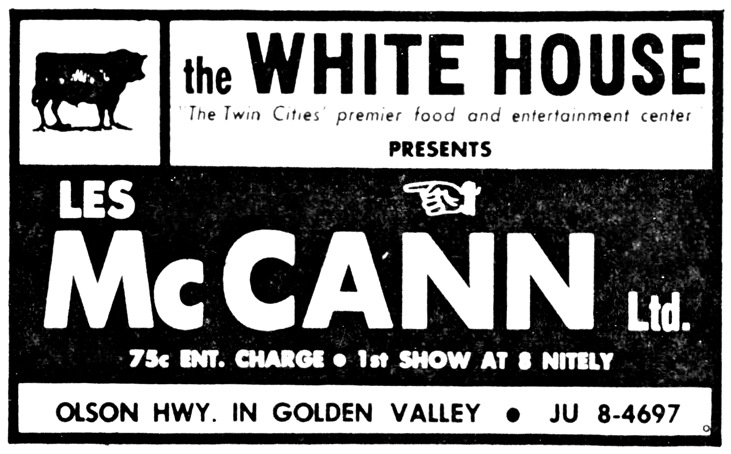
Minneapolis Star, May 12, 1964
MEADE LUX LEWIS
Meade Lux Lewis was a boogie-woogie piano player and composer who had been appearing in the Twin Cities since at least 1946.
From Wikipedia:
Lewis was quite fond of the Minneapolis area, where a niece lived, and would visit as often as he could. He appeared annually at the White House Restaurant in Golden Valley. He began a successful three-week engagement there in May 1964. Around two a.m. the morning of Sunday, June 7, leaving the parking lot of the White House and heading east on Olson Memorial Highway, Lewis’ Chrysler Imperial was rear-ended by one Ronald Bates, who was traveling an estimated 80 mph. Lewis’ car was pushed 400 feet, impacting a tree and killing him instantly. He was 58. Bates survived, but his passenger died the following day.
1965
In 1965 the waitresses were described as “shapely girls in split skirts.”
1966
Entertainment was diverse in 1966:
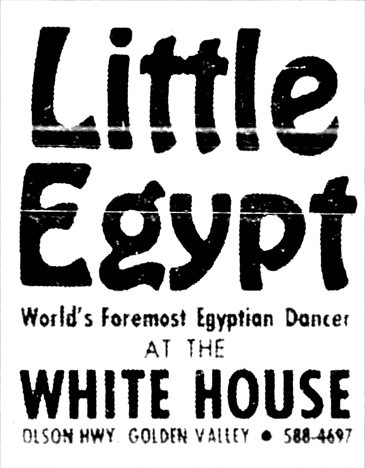
Minneapolis Tribune, April 22, 1966
From Irv Schectman’s Obituary:
In 1966 Schectman and broadcaster Herb Schoenbaum devised “A Festival of the Elegant Arts,” said Leigh Kamman, a jazz broadcaster for Minnesota Public Radio. The restaurant’s Bamboo Room started booking nationally known jazz acts such as Charlie Byrd and Roland Kirk for 10-day engagements. Schechtman bought radio spots to advertise his nightclub music, and Kamman and Schoenbaum programmed it onto the air waves “and kept the flame alive,” Kamman said. Through Schoenbaum’s connections in South America, Schectman also booked emerging Brazilian acts such as Manfredo Fest and Sergio Mendes, Kamman said.
The Festival lasted until 1969.
Son Paul:
He created and expanded the jazz club into a very progressive club. Cal Tjader, Sergio Mendez, Jose Feliciano, Charlie Byrd…. all performed there many times. Many of these performers would spend time at our home, giving me a rich and diverse cultural exposure to music and hip creative people. I was so lucky to have this exposure as a kid.
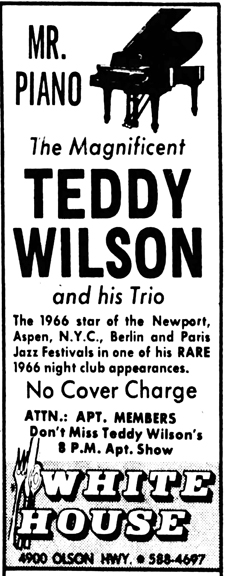
Minneapolis Star, October 13, 1966
1969
Turkish film star and belly dancer Ozel Turkbas was apparently a popular entertainer at the White House. The ad below is for March 1969, and she was also there that June.
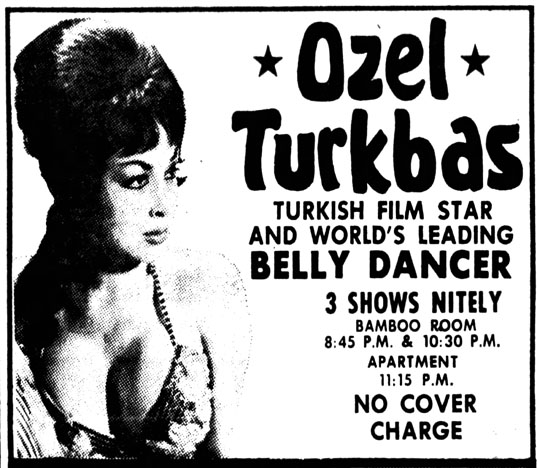
Minneapolis Tribune, March 8, 1969
The Americana ’69 performed for dancing.
In November 1969, Augie Garcia included the new Nob Hill at the White House on his itinerary when starting up his solo act.
1970
From Schectman’s Obituary
Schectman started La Societa dell’ Elegante Pranzare Italiano, translated as the Society for Elegant Italian Dining, to keep enticing what one reviewer called the cigar-and-mink crowd. A new menu of tomatoless Northern Italian cuisine ran each Monday night for a month: five to six courses and two or three wines. Until 1973, the price stayed under $10.
“In the 11 years I continued the society, I never — and I emphasize never — repeated a single course,” Schectman said when he sold the restaurant in 1983.
1971
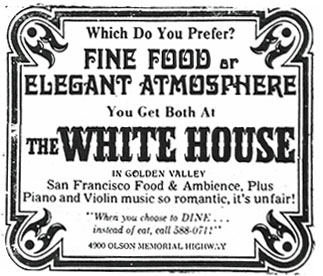
1971
1976
A restaurant review indicates that the only entertainment available was in the Apartment, which was still a private club requiring screening and a membership fee.
1983
Paul:
My father sold The White House [in 1983] and retired to Rancho Mirage with my elegant mother Jacqueline Schectman.
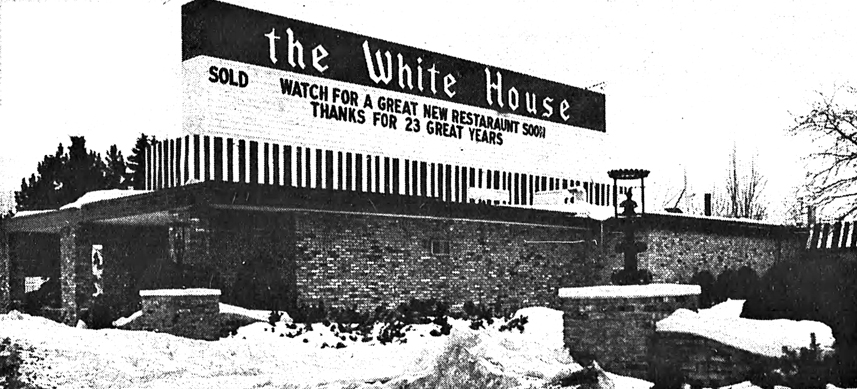
Minneapolis Tribune photo by Art Hager, April 7, 1983
Jacqueline passed away from lung cancer at age 60 in 1989. Irv Schectman passed away on September 10, 2003.
TAI PING
Schectman sold the restaurant in January 1983, to Philip Yen, and it was closed on January 15. Yen, who had owned the Mandarin Yen, obtained a liquor license on April 7. He opened a Chinese restaurant called Tai Ping that same month. The food reviews were great.

Minneapolis Tribune, April 19, 1983
1984
But in September 1984, the ads for help were suddenly identifying the place as the “Whitehouse,” and then stopped.
1986
On March 18, 1986, everything inside the building went up for auction, including a chandelier that was a smaller copy of the one in the Vienna Opera House. The item again reported that the building had been used as a restaurant since 1919.
The three-acre property was sold in December 1986 to a developer.
1991
The White House was torn down in 1991.
1995
In a report dated March 1995, the White House site was identified to be contaminated with volatile and semivolatile organic compounds, possibly construction material dumped there before the restaurant was built.
The site is now Sunrise Senior Living Center, if I’m correct.
Please see Club Royale.
The Whole Coffee House was in the sub-basement of Coffman Memorial Union (CMU) at the University of Minnesota.
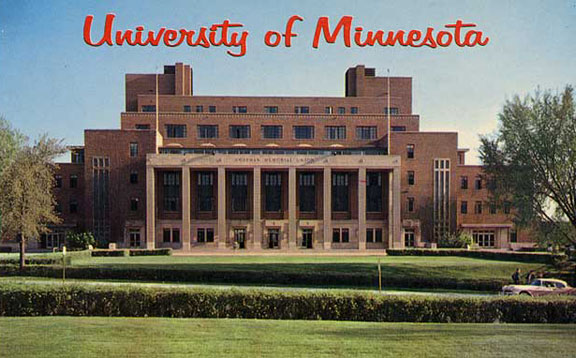
1960 Photo of CMU courtesy Minnesota Historical Society
THE GOPHER HOLE
In 1960 the U of M carved out a new room deep in the sub-basement of CMU. For years students knew the space (using a fitting moniker) as “The Gopher Hole.” This was described as “a common area for students and equipped with vending machines.”
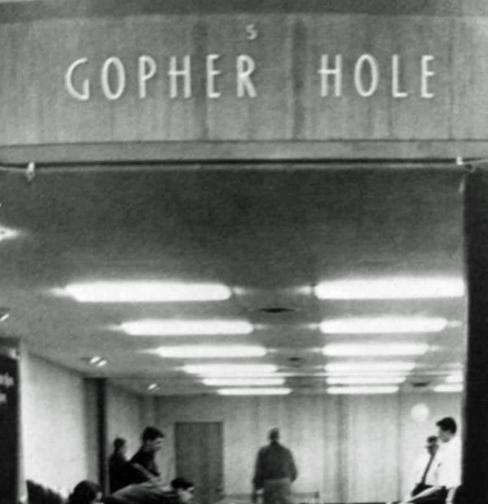
This may be a page out of a yearbook. Courtesy Larry Roberts.
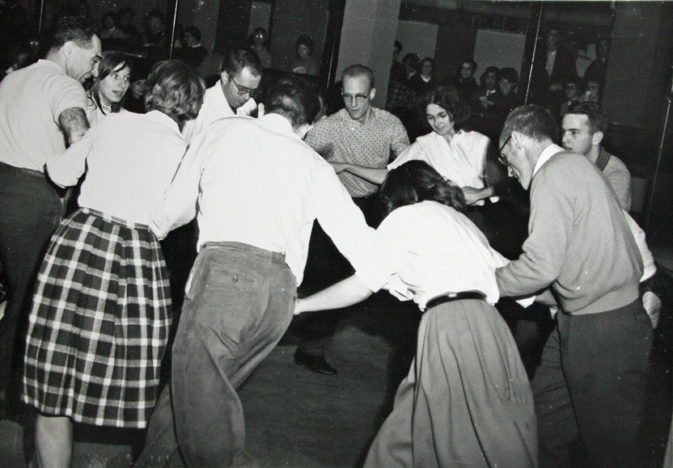
Square Dance at the Gopher Hole, 1962-1963. Photo Courtesy Whole Music Club/University of Minnesota Archives
THE WHOLE COFFEEHOUSE
Information for this section was taken in large part from the U of M’s website.
In 1968, the University decided to convert the Gopher Hole into the Whole Coffeehouse. “Student apathy toward union dances has transformed the Gopher Hole into the Whole coffeehouse on Friday nights,” reported a Minnesota Daily article from February 25, 1968. A student committee was formed to turn the space into a performance venue for local and touring folk musicians. Contacts were made with other universities in the Midwest to create a coffeehouse network for a wide variety of musicians.
The Whole Coffeehouse provided a gritty, bohemian showcase for unknown singer/songwriters and poets. Free peanuts were the Whole’s trademark, and admission to the shows was either free or as low as $1.50. Within a few years the Whole blossomed into the Twin Cities premiere hotspot for non-rock n’ roll entertainment. The list of early Whole performers is impressive: Leo Kottke, Sun Ra, Robin and Lucinda Williams, Jim Croce, “Spider” John Koerner, John Anderson, NRBQ, and Bonnie Raitt, to name a few. With the help of these performers, the Whole Coffeehouse became known as one of the top local venues for touring folk musicians in the late 1960s and early 1970s.
PHOTOS
The following photos were sent to me by the Whole Music Club, as it’s now called. I saw them online in a video they made and requested copies for my site. They responded the very next day, and I am so happy to be able to share them. The photos below are all from the 1970s. Many, many thanks!
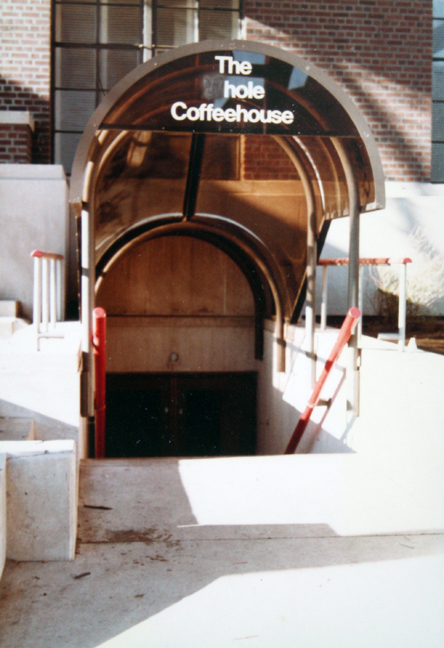
Photo courtesy Whole Music Club/University of Minnesota Archives
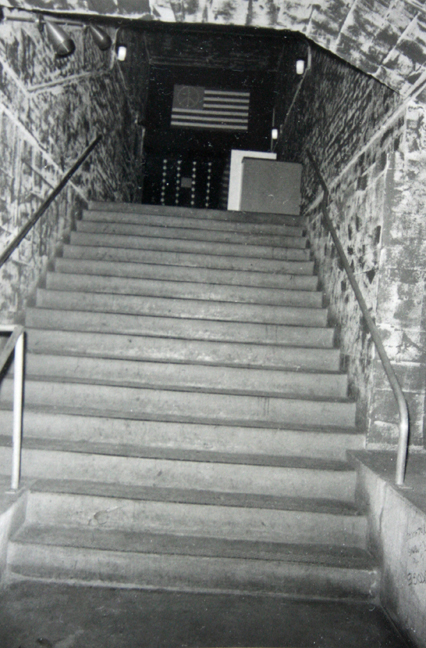
Photo courtesy Whole Music Club/University of Minnesota Archives
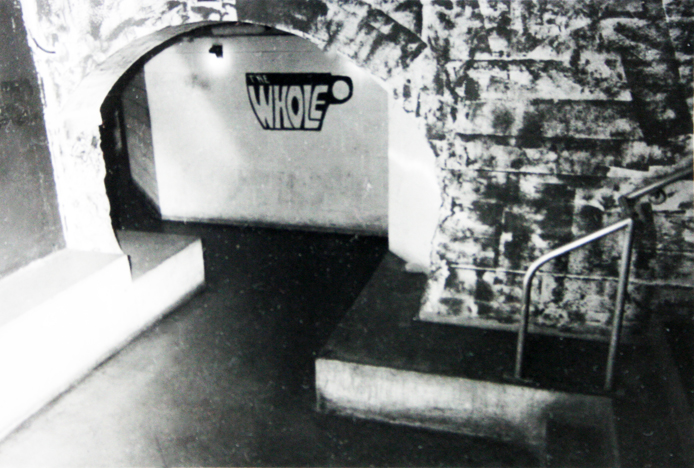
Photo courtesy Whole Music Club/University of Minnesota Archives
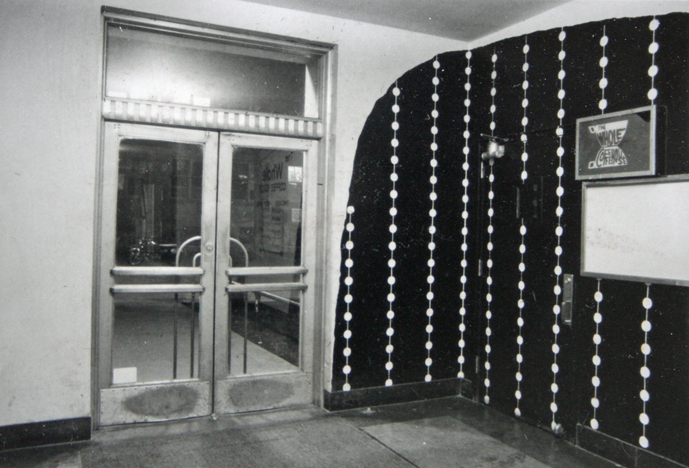
Photo courtesy Whole Music Club/University of Minnesota Archives
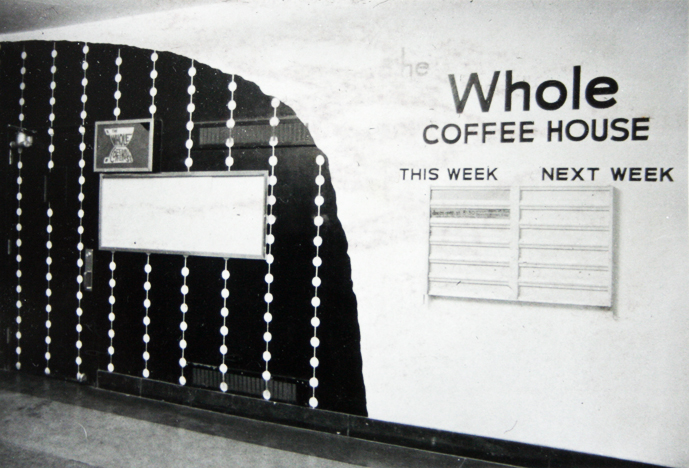
Photo courtesy Whole Music Club/University of Minnesota Archives
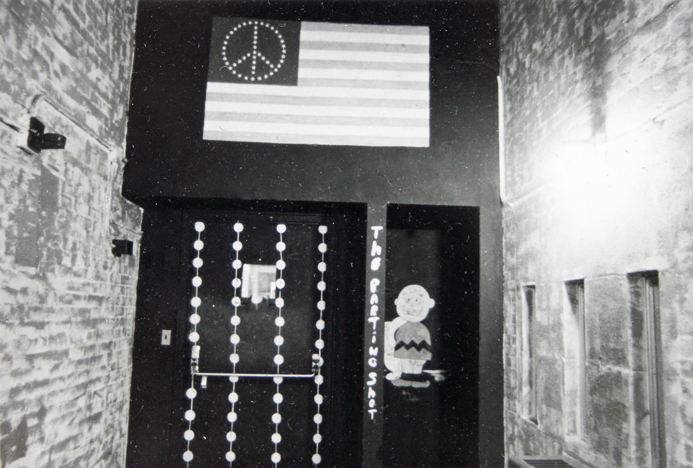
Photo courtesy Whole Music Club/University of Minnesota Archives
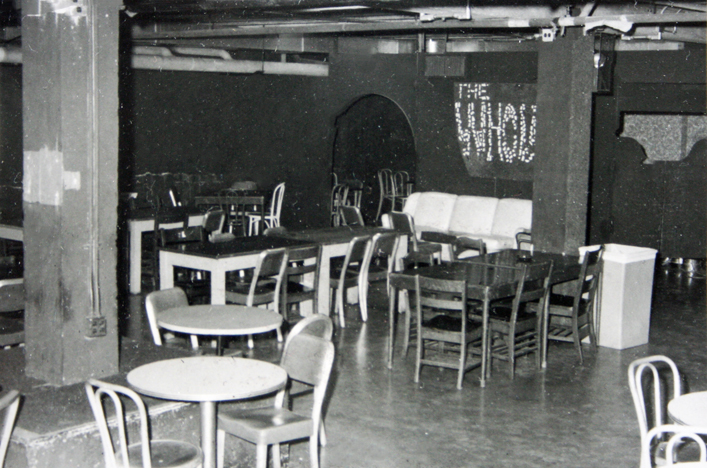
Photo courtesy Whole Music Club/University of Minnesota Archives
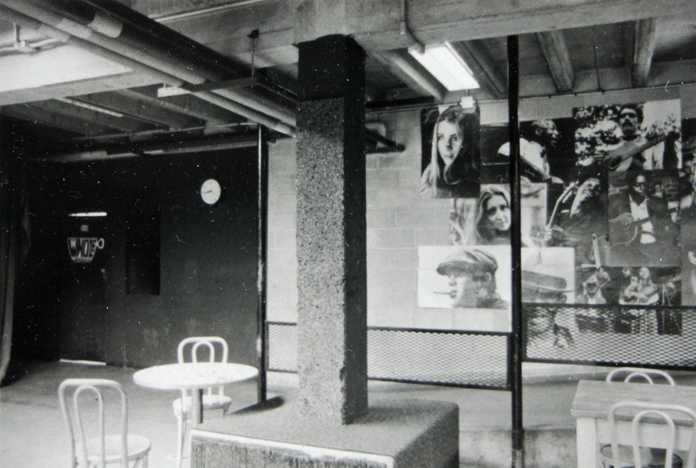
Photo courtesy Whole Music Club/University of Minnesota Archives
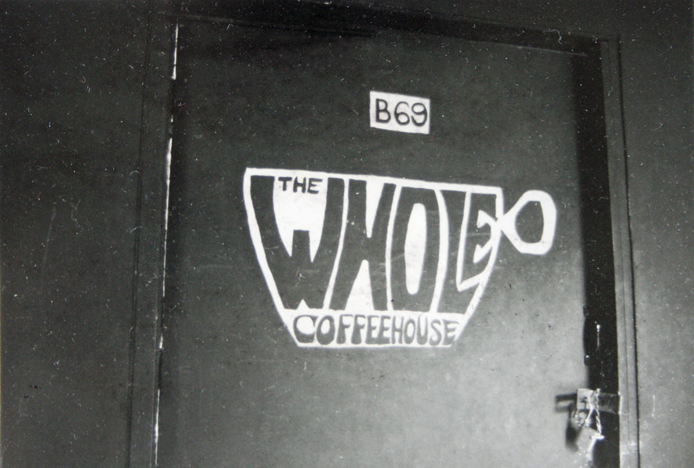
Photo courtesy Whole Music Club/University of Minnesota Archives
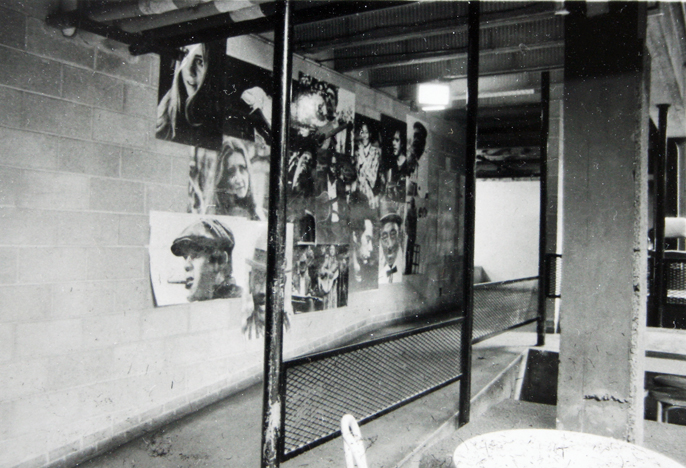
Photo courtesy Whole Music Club/University of Minnesota Archives
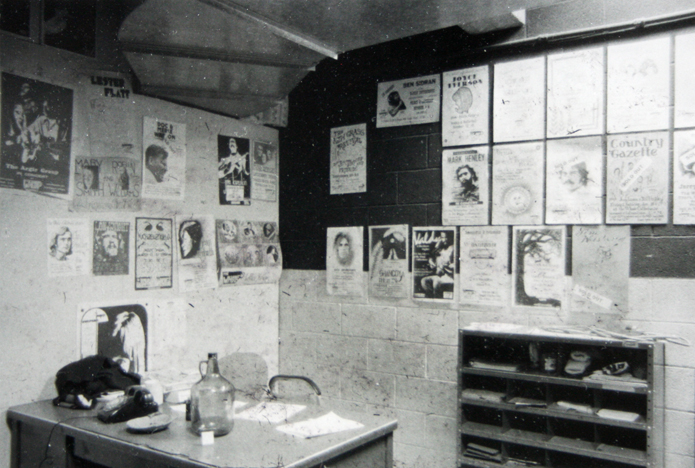
Photo courtesy Whole Music Club/University of Minnesota Archives
SHOWS AT THE WHOLE
This is by no means a complete list of shows at the Whole. The Minnesota Daily went offline, and that would have been the best resource. I hope it will give you a taste of the kind of music served up at the Whole Coffeehouse. These shows are from the Minneapolis newspapers, and a few other miscellaneous sources. Also please note that this website only runs through 1974.
1968
The first hit in the newspapers advertises a show in September 1968 by a “folk-rock and pop singer” named Brian Carney, who happened to be the son of actor Art Carney! The Whole was described as being located in the sub-basement of CMU.
In November 1968, a “jazz-rock ensemble” called the Montreal performed at the Whole, this time promoted to the basement of the Union.
1969
September 1969: Jerry Estes and Henry Moore, “country-folk music.”
1970
Tony Glover and Pepper Fog at Whole Coffeehouse, January 16, 1970
February 1970: Andy Robinson, straight from the Bitter End in New York, folk rock.
1971
Leo Kottke appeared at the Whole Coffeehouse on March 4, 1971, and got a good review from Hundred Flowers.
Brewer and Shipley at the Whole Coffeehouse, April 29, 1971
Big Mama Thornton came to the Whole Coffeehouse on May 4 and 5, [5 and 6] 1971.
Son House appeared at the Whole on May 10, 1971.
May 21 and 22, 1971: Cyril Paul – this show actually had an ad.
SOUL OF A CITY 1971
Monday, August 16, 1971: As part of the Soul of a City arts festival, the Whole featured:
- Lazy Bill Lucas, 7 to 8 pm
- Cyril Paul, 8 to 9 pm
- Kim Bloom, 9:30 to 10 pm
- The Sorry Muthas, 10 to 1 am
FALL 1971
Because the schedule below is not searchable, I’ll repeat what it says. And since there’s no guarantee that the shows were as shown, I’ll mark them with (schedule).
September 22 to 25, 1971: Dave Ray and Harmonica George Smith (schedule)
However, on September, 1971, Dave Ray and Big Mama Thornton were advertised.
September 29 and 30, 1971: Sorry Muthas (schedule)
October 6 to 9, 1971: Chris Smither, Mike Towers (schedule)
October 13 to 16, 1971: Gary Burton (schedule)
October 22 to 23, 1971: Willie Murphy and the Bumblebees (schedule)
October 27 and 28, 1971: Jean Redpath (schedule)
October 29 and 30, 1971: Chris Karney (schedule)
November 3 to 6, 1971: Jim Kweskin (schedule)
November 10 to 13, 1971: Lon Knight (schedule)
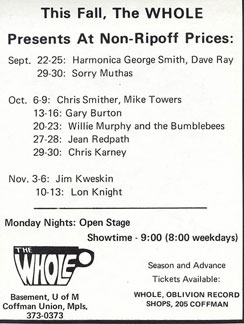
1971
Bonnie Raitt did a stint at the Whole Coffeehouse on November 17-20, 1971.
1972
Kevin Odegard, with Skogie and the Flaming Pachukos, performed on March 4, 1972.
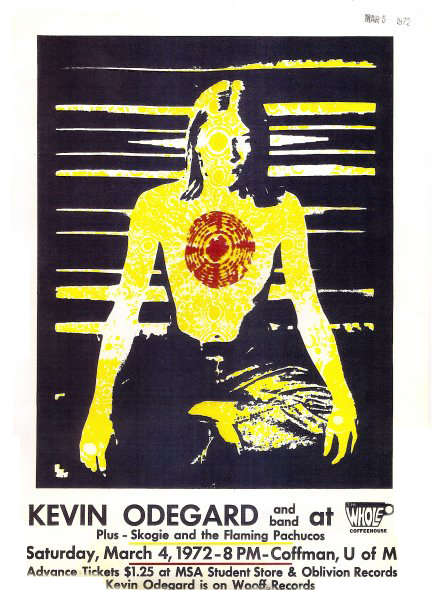
Bonnie Raitt graced the Whole Coffeehouse at the U of M on October 6 and 7, 1972.
1973
In February 1973, the Minneapolis Playwriting Laboratory staged one-act plays at the Whole over two nights.
March 31, 1973: John Hammond and Jerry Jeff Walker
Gram Parsons appeared at the Whole Coffee House April 27 and 28, 1973.
There is a concert on YouTube by Townes Van Zandt recorded on September 6, 1973.
September 16, 1973: Jerico Harp
October 28, 1973: Shangoya
1974
January 24 to 27, 1974: Jerry Jeff Walker
Two nights in May 1974: Rambling Jack Elliot
Sonny Terry and Brownie McGhee appeared at the Whole Coffeehouse at the U of M on June 7 and 8, 1974.
July 26, 1974: Blackburn and Hughes
August 2, 1974: Papa John Kolstad
August 9, 1974: Guitarist Eric Mann
August 16, 1974: Jerry Rau
Bluesman Furry Lewis graced the Whole Coffeehouse on November 15 and 16, 1974.
November 1974: A concert featuring Townes Van Zandt recorded at the Whole was broadcast over KSJN – no information as to the date of the concert.
December 6 and 7, 1974: Tom Waits and Joyce Everson
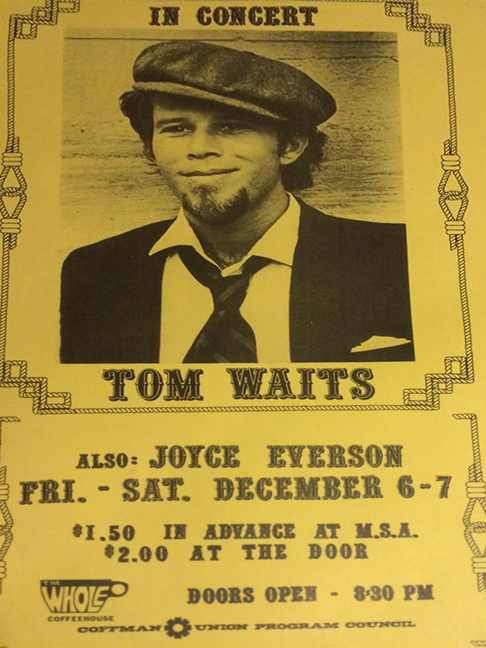
Image courtesy Paul Strickland
THE WHOLE MUSIC CLUB
In the fall of 1983, the Whole became a full-fledged rock venue. To reflect this change, the “Whole Coffeehouse” became the “Whole Music Club.” The type of music changed with the times, and continues to be a popular campus music venue today. Or will be again after the Covid crisis is over.
Save
The Wig and Bottle was located at 2501 Marshall Street NE at Lowry Ave. in Minneapolis.
In 1937 this was called the River Tavern
By 1946 it was Danny’s River Tavern, owned by Danny Bochnak.
Before 1951 it had become the Lowry Bar.
In 1951 John Skowronski bought the Lowry Bar.
THE WIG AND BOTTLE
Skowronski expanded the bar into an English-style bar and restaurant in 1965. Will Jones reviewed it on July 4, 1965, but only reported on the food.
Music was not advertised except on holidays. The ad below for a Valentine’s dinner promises a musical serenade.
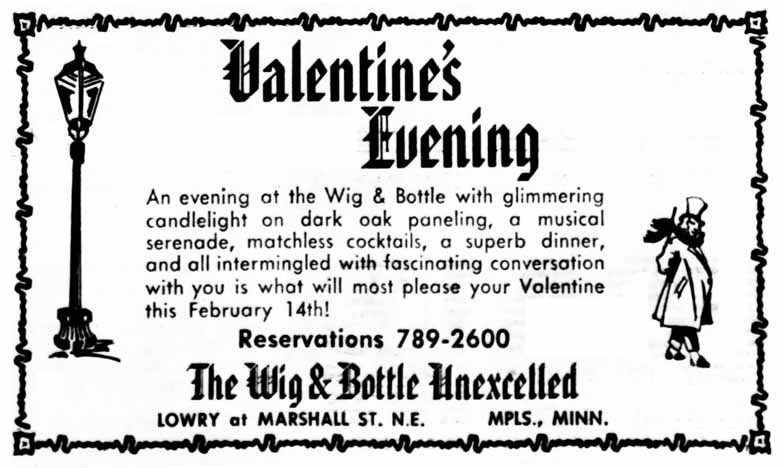
Minneapolis Tribune, February 1970
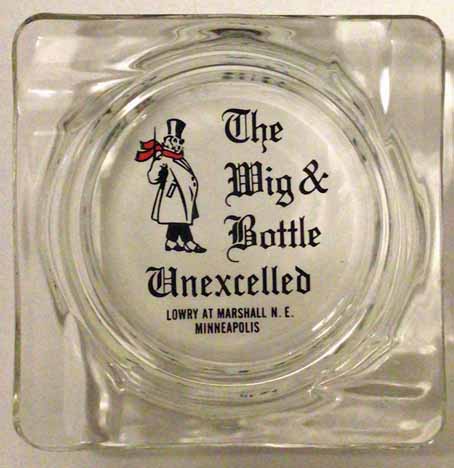
From the collection of Mark Youngblood
Again, this special ad for St. Patrick’s Day below mentions strolling musicians:
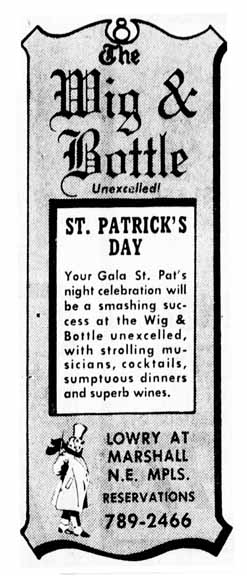
Minneapolis Star, March 1971
Lastly, another Valentine’s Day ad specifically mentions Skeets Langley and His Music Makers, serenading you through your special dinner:
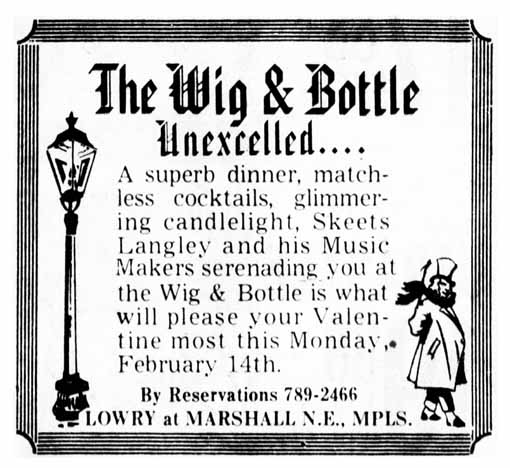
Minneapolis Tribune, February 1972
BURNED TO THE GROUND
On Friday, May 18, 1979, fire broke out in the basement of the building. Sprinklers were required and Skowronski was ordered to install them, but was given three extensions. Four firefighters were nearly lost in the basement before it collapsed. The fire started in a defective water heater that was about to be replaced. A waitress noticed the flames at 7:45 pm and the building, which was full of customers, was evacuated. The building was not rebuilt. (Minneapolis Tribune, June 1, 1979)
Skowronski sold the land in 1984.
The site became Betty Danger’s Country Club in November 2014. It is closing in 2022.
Save
The Wigwam was at 383 Wabasha in St. Paul.
In February 1944 it was advertising as the Newest Stage Bar in the Twin Cities. Entertainment 2 o’clock to closing.
The music pavilion at the Wildwood Amusement Park was a building where Park-goers could hear local and national musicians during the Park’s run.
Wildwood was located on the southeast shore of White Bear Lake in what is now the City of Mahtomedi, Minnesota. Articles in the St. Paul Globe indicate that Wildwood was the name of a picnic ground as early as 1889, but it was not considered an amusement park (or “resort” as it was known then) until June 1892, when it was built up in conjunction with the St. Paul and White Bear Electric Railroad by Lane K. Stone and Walter S. Morton.
The Park was built to attract riders to the streetcar system. It was open from Memorial Day to Labor Day, 11 am to 11 pm. Riders would travel up to 60 miles per hour from St. Paul, arriving at the terminal and walking under the tracks in a tunnel to the Park. Admission was free. It provided rides, treats, and beach activities similar to those of Excelsior Amusement Park, although the latter lasted much longer and lingers in our memory today.
There was a pavilion where people could dance, and/or a casino – this was not a gambling casino but more of a promenade where entertainment was presented. One classified ad in 1892 requested a “good pianist and novelties” for the casino. The music pavilion included a restaurant and dance floor.
1892
Dances were first held in July 1892, with music by Seibert’s Band/Orchestra. George Seibert Jr. led the house band until the end of the decade, it appears, with some exceptions.
Here is a delightful article from the St. Paul Globe (July 17, 1892) that really should have a byline. The multiple headlines are:
WHITE BEAR FLASHES
The Season at its Height at the Popular Lake Resort.
Select Hops All the Rage During the Past Week.
Even Sleepy Mahtomedi Woke Up to the Merry Doings.
The high tide of social life at the lake has been reached, and for the next four weeks White Bear will be at its very best, provided the weather does not relapse into its former dampening condition. The spirit of dancing seems to have taken possession of everyone young and old, and nearly every evening finds some merry throng gathering together to worship at the shrine of Terpsichore. On Tuesday [July 12] and Saturday [July 16] of last week the dances at the pavilion were largely attended, and the floor was thronged with joyous youths and maidens, forgetting for the nonce the past and the future, and thinking only of the fleeting pleasures of the present.
Wednesday evening [July 13] the new hall of the Wildwood Casino was used for the first time, and pronounced “perfectly lovely” by those who glided over its polished floor. There was a goodly gathering, and all danced several numbers to the sweet strains of Kleinst’s band. To be sure, the electric lights did not work, necessitating dancing in the dark, but many thought that an added enjoyment.
THE ELECTRIC LINE
The official inauguration of Wildwood Park and the Electric Line was held on July 21, 1892, with a reception at the Park, accompanied by Seibert’s Orchestra. Speeches from the event were duly printed in the St. Paul Globe, as was an extremely informal letter of regret from President “Ben Harrison.” (July 22, 1892)
On July 24, 1892, Wildwood was referred to as a “new resort.” There was a heat wave going on and thousands were expected to arrive on the trains that were running every 15 minutes from St. Paul. Seibert’s Orchestra of 27 pieces was there to entertain the masses.
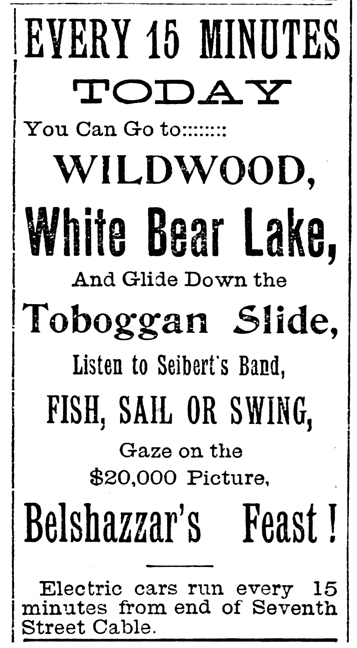
St. Paul Globe, July 31, 1892
By September 1892, a full band was on hand daily.
1893
P.L. Kleist’s Second Regiment Band entertained; there were hops on Tuesday and Friday evenings.
1894
Dances were held every afternoon and evening; Seibert’s First Regiment Band gave concerts three times a week.
1895
Knauff’s Orchestra entertained on the Fourth of July, 1895. The rest of the bill looks like a vaudeville act!
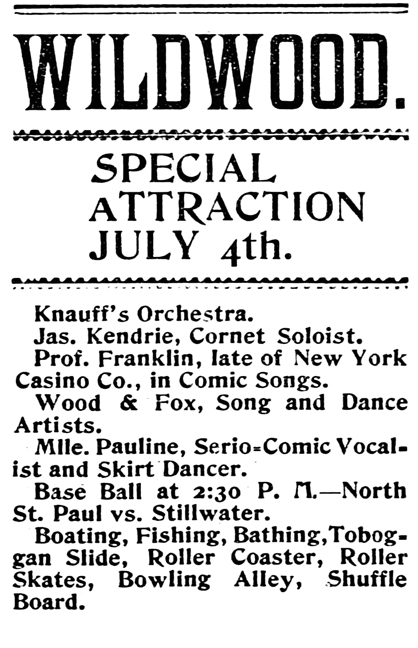
St. Paul Globe, July 3, 1895
1896
There was music every evening in the pavilion.
1898
In 1898 the Park was acquired, along with the rail line, by the Twin City Rapid Transit Corp. (TCRT) (Minnesota Historical Society)
1900
Longtime entertainers, both as a duo and leading an orchestra, were Wolff and Barrett. A.N. Wolff was a violin player. Other popular musicians in 1900 were the Mandolin Orchestra and Miss Bessie Meier and her 11-year-old brother, Master Tommie.
On May 27, 1900, the St. Paul Globe reported that, “The stage has been removed in the dancing pavilion and 40 feet more added to the dancing space, which makes the pavilion now almost ideal in this respect.”
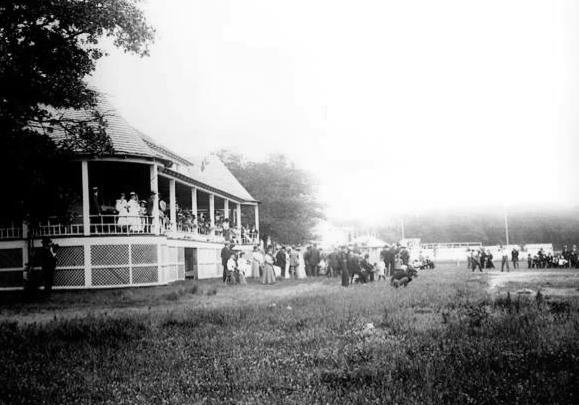
Wildwood Pavilion, @ 1900. Image courtesy White Bear Lake Area Historical Society
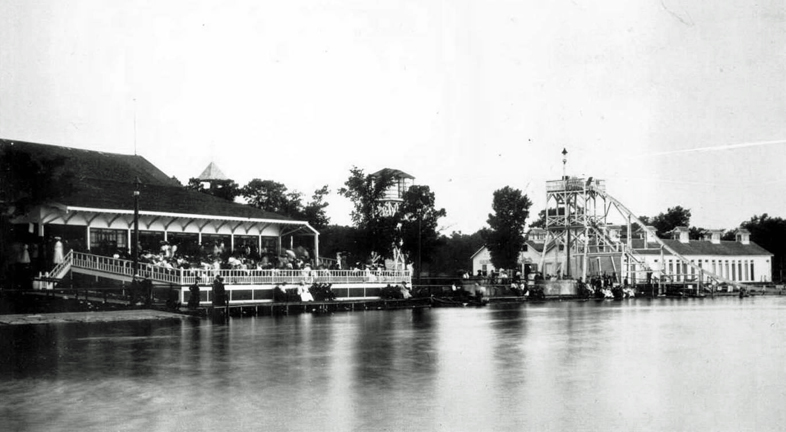
Wildwood Pavilion, @ 1900. Image courtesy White Bear Lake Area Historical Society
1905
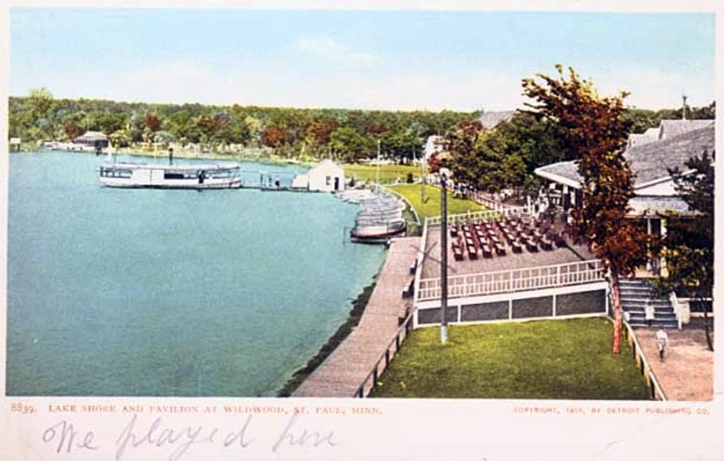
Pavilion, 1905. Image courtesy Minnesota Historical Society
1908
The dancing pavilion burned down and was rebuilt in red brick.
1910
Note that the Figure 8 Coaster was the original name for the Roller Coaster.
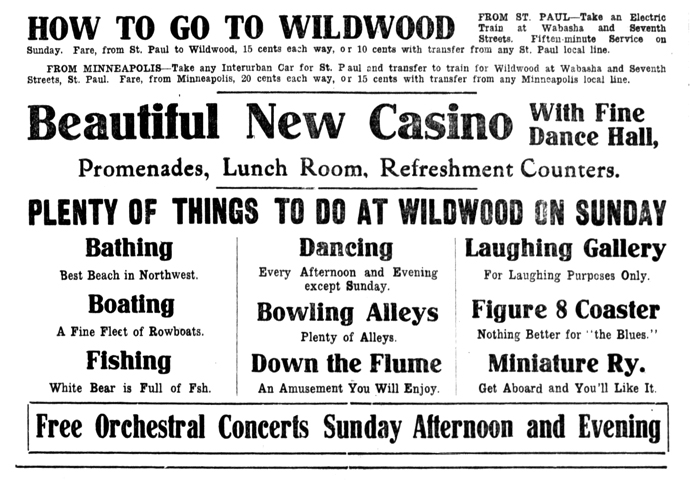
Minneapolis Tribune, July 9, 1910
1911
A 50 x 55 ft. addition was built on to the pavilion to increase the size of the cafe and kitchen. (White Bear Life, May 11, 1911)
1912
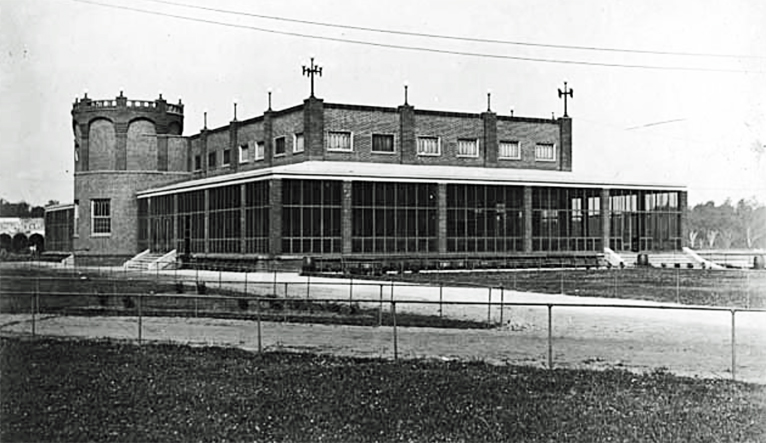
Pavilion, 1912. Image courtesy Minnesota Historical Society
1914
In about 1914, people started to build summer cottages along the shore of White Bear Lake. Folks from the City could ride up for the weekend, rent a cottage, and not have to worry about making the last streetcar home.
1916
The ad below was essentially the same as the one in 1915 and 1917
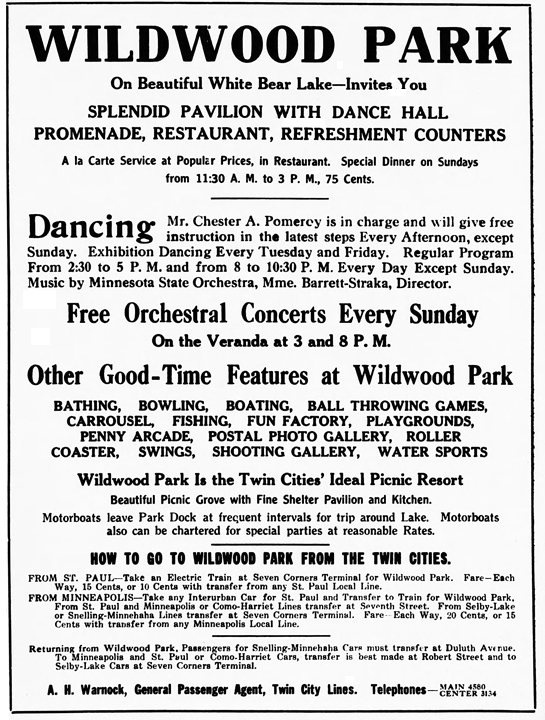
The Irish Standard, July 15, 1916
1920
Entertainment for dancing in 1920 and 1921 was provided by the Minnesota State Orchestra.
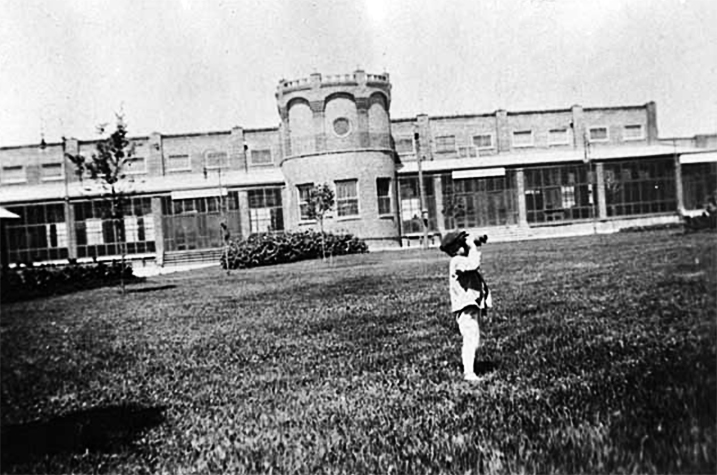
The new Dancing Pavilion, 1920. Image courtesy Minnesota Historical Society
1920s
The Minnesota Historical Society dated this card to the 1920s. A newspaper search only found Don Gonzales with his own radio show in 1933.
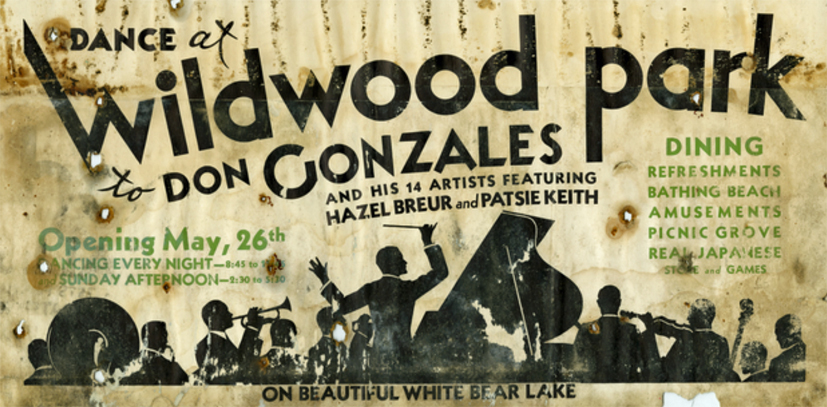
Wildwood Bus Card, 1920s. Image courtesy Minnesota Historical Society
The Pavilion is said to have hosted such national musicians as Guy Lombardo and Red Nichols, but I found no ads for those.
1928
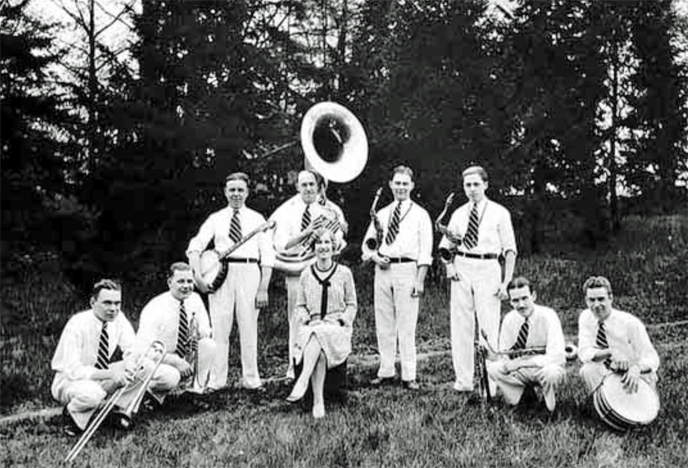
Wildwood Orchestra, 1928. Image courtesy Minnesota Historical Society
DECLINE
A couple of major factors led to the decline of Wildwood. First, as more people owned their own cars, they had the freedom to travel to more places than those on the streetcar lines. By the late 1920s, families were vacationing further afield and Wildwood’s attendance dropped.
Then came the Great Depression in 1929, and there was little money for recreation throughout the 1930s for most people.
RADIO
1929
From May 26 to August 29, 1929, radio listings appear sporadically at 10:15 pm on KSTP Radio for a dance program emanating from Wildwood. The first one says “Dance to the alluring tunes of King Cole and his orchestra direct from Wildwood – KSTP (Minneapolis Journal) The rest just say Dance Program (or Feature) from Wildwood.
1930
The KSTP Radio shows start up again on May 25, 1930, again at 10:15 pm. They are listed as “Wildwood Orchestra” or “Wildwood Dance Orchestra,” and the last one of the season is listed on August 24, 1930.
1931
The KSTP Radio shows began on May 29, 1931, again at 10:15 pm. They are listed as “Wildwood Orchestra” or “Wildwood Dance Orchestra,” and the last one of the season is listed on August 28, 1931.
1932
Only one listing for a KSTP Radio show is found for 1932, and that is on June 7. It is listed as “Wildwood Dance Orchestra,” from 10:15 to 11:15 pm.
1936
The Bathhouse burned down in February 1936. Huge snow drifts, lack of long hoses, and frozen water pipes made fighting the fire impossible. Damage was estimated at $25,000.
1937
Contrary to dates published of 1932 and 1936, the Park was open in 1937, starting in May. Radio listings for the Wildwood/Billy Kugler’s Orchestra on WTCN can be found from Sunday, June 6 to Thursday, August 26, 1937.
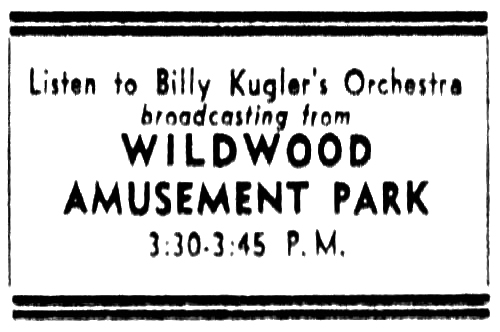
Minneapolis Tribune, June 6, 1937
Fats Waller made a one-night stand at Wildwood on July 28, 1937, according to the “Under Your Hat” column in the July 22, 1937, issue of the Minneapolis Journal.
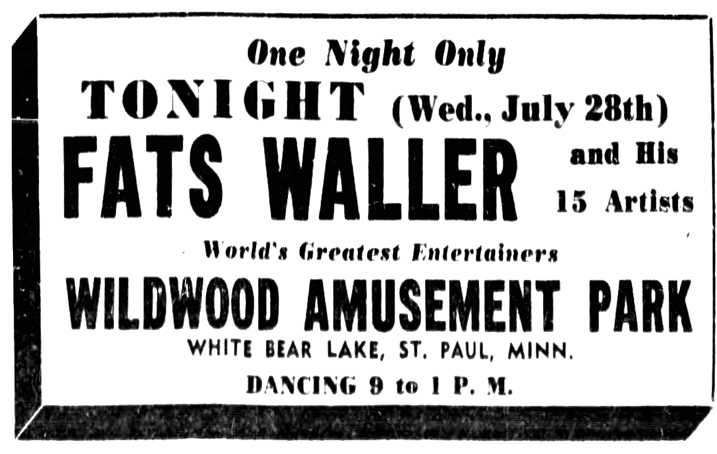
Minneapolis Tribune, July 28, 1937
1938
On April 10, 1938, the TCRT announced that it would abandon Wildwood and tear down the dance pavilion and other buildings in the spring. (Minneapolis Tribune) A wrecking company’s ad indicated that it was being dismantled that August.
The land was sold and subdivided for development. The streetcar stopped running to the area in 1951. The only sign that it ever existed is a plaque at a small park in Willernie near the place that visitors entered Wildwood Amusement Park.
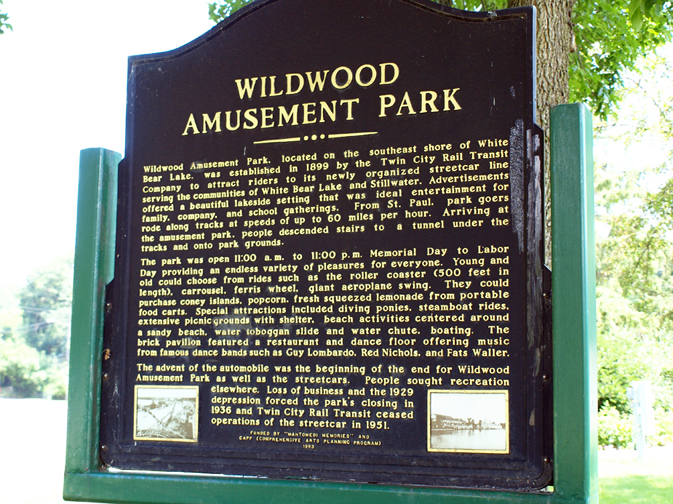
Image from Forgotten Minnesota
Sources:
Forgotten Minnesota – “The End of the Line: Wildwood Amusement Park.” June 30, 2011
White Bear Lake Area Historical Society Facebook Page
Confusion reigns here:
Williams Bar was owned by Eugene Williams and was located at 603 Hennepin. It was closed due to a fire in about August 1958.
Owned by Bill Warner
2911 Hennepin Ave., Uptown Minneapolis
603 Hennepin: Dixieland venue. Had been a bakery and was converted to a bar in 1953. Harry Blons had a band there for some years, but the club burned in 1958. It reopened at 9th and Hennepin but no longer featured jazz (as of 1964).
26 So. Sixth Street. Since 1946 this has been the location of Murray’s Restaurant.
This bar and dance hall was located at 9946 77th Ave. No. in Maple Grove. This is in the NW sector of the intersection of Brooklyn Blvd. and Highway 169. It had an on-sale and off-sale license.
It was owned by Raymond (Ray) A. Wolff, who died in 1994.
It was the hangout of the kids going to Hennepin Technical Center’s north campus, from 1967 to 1989. My Facebook informant remembers that it was mostly underground, pretty big, and had sawdust on the floor. You had to walk down about 20 stairs to get to it.
I received an email from a relative, who tells us,
It was my grandfather’s bar and named by my aunt, who was the youngest of six kids. During the day it was a place for workers in the gravel pits that were next to the bar, to get a bite to eat and a drink – usually a beer. At night it was a hang-out, a place to listen to bands and dance. My grandparents would host a big Christmas dinner there every year.
When the bar was closed it became “Sneakers Nite Club” and didn’t have nearly the same customer base.
It is now within a bigger parcel that is over $1 million worth of vacant land.
The Wonder Vue Cafe was located at 1007 Sixth Ave. No.
THE BUILDING
There were actually two properties listed on the City’s permit card for 1001 – 1007 Sixth Street N.
One was a 48′ by 50′ frame building with two stores and two apartments, built for $5,000 in April 1913.
The other was of the same dimensions, but just a store building built for $2,000 in June 1913. Given the address, I suspect that 1007 was the latter building.
The first use of the building found was a dry goods store run by Benjamin Goldman, listed in the 1930 directory.
FRESNO CAFE
The Fresno cafe was at this address in 1937 and was owned by Joe and Emma Taylor. Whether it had music is unknown. On January 22, 1937, Joe was jailed when he shot a man over a broken beer glass. The story is that the man smashed a beer glass on the floor and Joe asked him and his party to be more careful. Belligerent, the man started to curse and threaten Joe with a bottle. Joe said to stop or he would shoot. He shot. What did not bode well was that Joe was black and that the dead man was white. Joe was tried for murder and found not guilty by a jury in March 1937.
In October 1938, an ad appeared in the Minneapolis papers offering a beer parlor for sale, cheap. It was described as being across from the Sumner project.
THE WONDER VUE CAFE
The Wonder Vue first appears in July 1940, although it may have been here earlier. Its proprietor was Leon Burnette, and it offered “First Class Entertainment.”
In December 1940 it advertised that it was under new management, which must have been Horace Nelson. An ad from June 1941 in the Minneapolis Spokesman called the Wunder Vue “A Place to Enjoy the Evening” – kind of a tepid endorsement but hey… The small ad did say that there was “Good Food – Entertainment.”
Horace ran into a string of bad luck. In August 1941 he was arrested for allowing gambling in his place. Then in October 1941 he was busted again, same charge plus selling liquor without a license (he probably only had a 3.2 beer license).
An interesting note is that in an article about a raid on the Clef Club, another hot spot on “The Avenue,” in 1942, it said that proprietor Horace George Davis had been convicted for selling liquor without a license at the Wonder Vue in 1941. Our same Horace? (Minneapolis Star, January 15, 1942)
HUB CAFE
By January 1942, the spot had become the Hub Cafe. And by April 1942 it was already under new management, with good music, entertainment. The Hub featured entertainment by Walter Lear and His Gents of Rhythm, Friday through Sunday in September 1942.
But in December 1942 the “alleged all night spot” was raided by state agents by order of Governor Harold E. Stassen. Mayor Kline agreed with the move, and said that his hands had been tied for lack of manpower because so many men from the police force had gone into the military. Ben Wilson, the “Mayor of the North Side,” was named as the proprietor of the Hub at the time of the raid. About 100 people were in the club at the time. (Minneapolis Star, December 28, 1942)
In the 1950 directory the address is listed to the Factory Surplus Mart.
The building was wrecked in January 1957.
Woodman’s Hall, (also known as Woodman Hall) owned by L.T. Woodman, was identified as the first place of amusement in Minneapolis in an article about the history of local theaters (Minneapolis Tribune, January 1, 1892). It hosted the “old Salty St. Claire troup,” according to the article.
It was established in 1857 and was located on Hellen Street, now Second Avenue South between Washington Ave. and Second Street. The building had been a Sunday School, and by 1881 was the St. James Hotel. (Minneapolis Tribune, January 11, 1881).
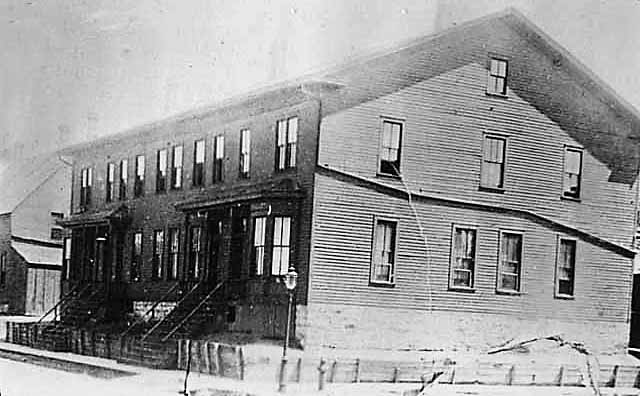
Woodman Hall, 1860 – courtesy Minnesota Historical Society
A description from 1888 describes Woodman Hall as a place where “the itinerant showman closed his clinging fingers on the hard-earned ‘two-bit’ pieces of the small boy and gallant swain, and where public meetings were usually held. This building was later moved to Fourth Street and Sixth Ave. South and is now the Tremont House.” (Minneapolis Tribune, October 20, 1888)
The 2018 Minneapolis Music Survey has this to say about Woodman Hall:
Considered one of the first music halls, it opened above a drug store on Washington and Second Avenues South. The theatre had no balcony no gallery and no elevated seats. There was no stage entrance so performers passed through the auditorium to reach the stage. B.E. Messer opened music classes here in 1857 and various bands played here. It became the home of the masonic hall by 1958 and a second Woodman’s Hall was constructed diagonal across the street, also on the third floor of a stone building. In 1908 it was considered an “ante-bellum meeting place along with Fletcher’s Hall, Woodman’s Hall No. 2, and Harrison’s Hall.
Messer was a singer and violinist who had come to Minneapolis in 1852 and was elected Hennepin County’s second Sheriff in 1854. While he was in Minneapolis he established the City’s first singing school, and was also engaged as a carpenter. In 1855 he went to Hutchinson to help establish that town, and in 1861 he took a job in Washington, DC, where he died in 1895.
711 W. Broadway, hosted “Old Tyme” dances every Saturday and Sunday night in late 1944. “Be Assured of a Good Time – Good Music and a Friendly Crowd.”
Woodmen’s Hall was located at 711 West Broadway at Lyndale Ave. No. in Minneapolis. It should not be confused with Woodman Hall, which was the City’s earliest theaters, owned by a fellow named Woodman.
THE WOODMEN
This Hall was built by the Modern Woodmen of America (Prospect Camp, Inc. No. 1035). Wikipedia tells us that
Modern Woodmen of America was founded by Joseph Cullen Root on January 5, 1883, in Lyons, Iowa. He had operated a number of businesses, including a mercantile establishment, a grain elevator and two flour mills; sold insurance and real estate; taught bookkeeping classes; managed a lecture bureau; and practiced law. Root was a member of several fraternal societies throughout the years. He wanted to create an organization that would protect families following the death of a breadwinner.
This was essentially a member-owned life insurance company, but back then it had its quirks. It would only insure white males between the ages of 18-45 from the 12 “healthiest” states, and residents of large cities (which Minneapolis was apparently not) were ineligible for membership. Others who were disqualified were “railway workers, underground miners, gunpowder factory employees, liqueur wholesalers and manufacturers, saloon keepers, ‘aeronauts,’ sailors on the lakes and seas, and professional baseball players.” So basically if you were healthy as a horse you were eligible to be a Woodman. The tax-exempt organization exists to this day, with 750,000 members.
THE BUILDING
The building was built as a lodge hall in 1925. The brick and tile building measured 50 ft. by 100 ft. by 32 ft. and had two stories. A dance hall permit was obtained from the beginning.
It was referred to in the papers as the MWA or Woodman Hall, and used by many fraternal organizations, lodges, and clubs for balls, meetings, parties (especially bunco parties), and dances.
MUSIC AT THE HALL
Here’s an ad from an obscure paper (Hennepin County something or other – I’ll find it). It’s from New Year’s Eve, 1935, but curiously doesn’t give the name of the place, just the address. Maybe the Woodmen were afraid of the Whoopie the Red Peppers would stir up.
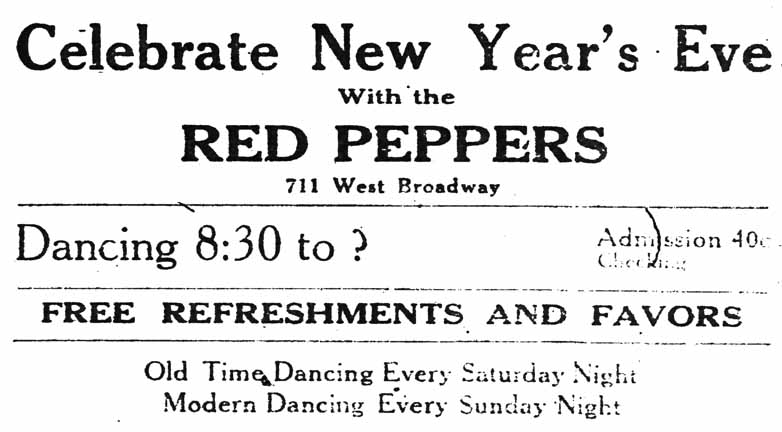
October 1944 marked a big change in strategy, with a big ad for a dance at the hall. Like many ballrooms, the music was “old time,” and so were the people, restricted to 28 and older. Lou Peterson led the orchestra through December 1944.
[October 4, 1944 Trib]
In January 1945, the building was advertised for sale as an insurance company foreclosure. It was described as having two stores, three offices, a basement, and the lodge/dance hall. The advertised price was $20,000. (Minneapolis Star Journal, January 29, 1945)
Starting in about September, dances were advertised that only gave the address. Reuben Olson was listed as the manager.
[September 14, 1945]
This ad is confusing. Why is a venue north of Robbinsdale called “formerly 711 West Broadway?”
[June 14, 1947]
But what’s this? Woodman Hall is back in 1948! And it is giving dancing lessons. October 4 to November 20
[October 16, 1948]
Ads were published for young boys and school girls – don’t know what that was about.
AUDIOTEK
Next we see is a large ad for AudioTek Recording Studios.
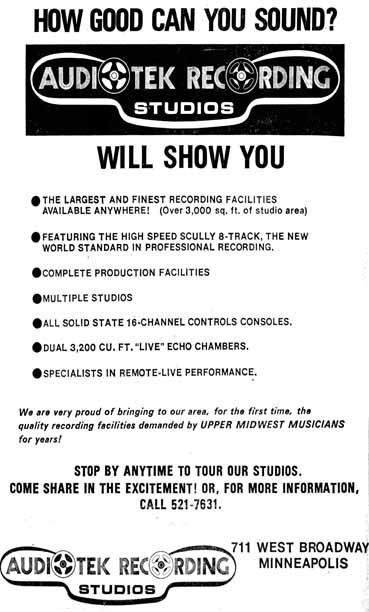
December 8, 1968
WHAT GOES UP…
A demolition permit was issued on December 4, 1981.
The current building there was built in 1982.
Worwa’s was a restaurant located at 2300 University Ave. NE in Minneapolis. Although there are newspaper reports of goings-on at this address going back to 1912, the permit cards only go back to 1938, and the property tax records go back to 1947.
Just for fun, the papers say that the place was:
- Public Inn Saloon, 1912
- Speakeasy, with copper tubing in the walls leading to a copper tank in the basement – 1925
- Oak Automotive Co. – 1929
- Marie Tapsak’s Tavern – 1936
- Ye Olde Bar – 1937
By 1939 it was Worwa’s Bar, and in 1942 owner Joseph Worwa was in big trouble for tax evasion, owing $2,500 in liquor tax to the Feds. He plead guilty, was fined $1,000, and given 6 months in prison, but the sentence was suspended and he was given probation.
At the end of 1954 Joe and his son Donald Worwa were arrested in a gambling raid.
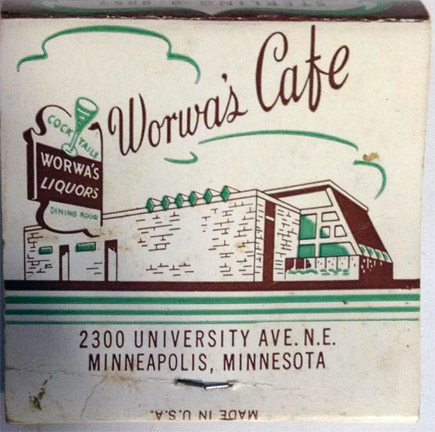
From the collection of Mark Youngblood
In May 1955 it became Worwa’s Cafe, able to seat 200 people in the Skylight and Cedar Rooms.
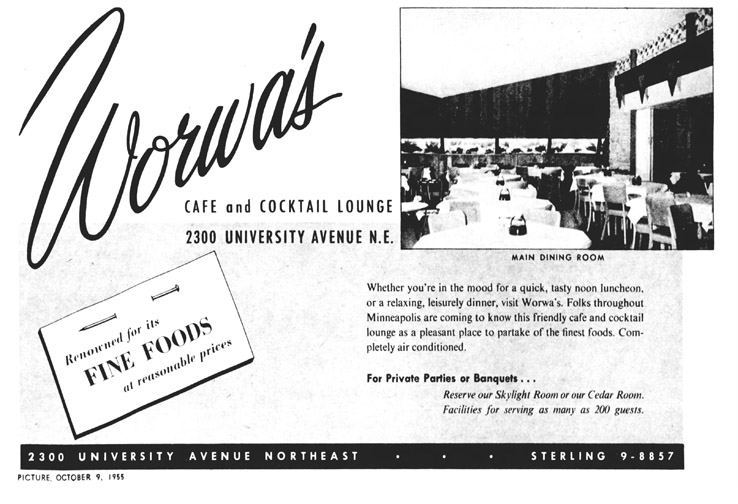
Minneapolis Tribune, October 9, 1955
In the 1960s it was Worwa’s Cafe, and music came to the venue.
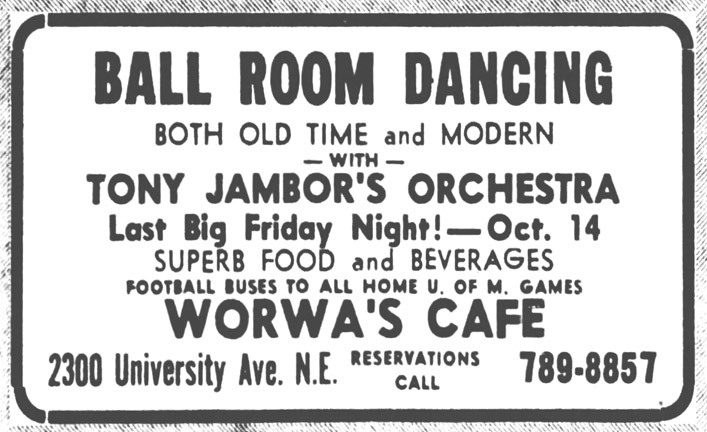
Minneapolis Star, October 13, 1966

Menu cover courtesy Hennepin County Library
An article in the Minneapolis Star reported that Worwa’s was in Federal bankruptcy court, which approved the sale of the bar to Gordon B. Solz, former manager of the Central-Hennepin Liquor Store, 608 Central Ave. NE. The sale price approved by the court, subject to debts, was about $225,000. (May 22, 1968)
ARTHUR’S FOUR SEASONS
Will Jones reported on the transition of Worwa’s to Arthur’s Four Seasons, saying that the new owner was Art Soltz, a food wholesaler. Art turned over management of the place to his four sons, who had previously run Central-Hennepin Liquors and were known for getting around the prohibition of the use of the world liquor in ads in the Minnesota Daily by using synonyms such as booze, suds, and juice instead.
Art wanted to call the place the Four Sons, Jones reported, but the four sons overruled him and called it Arthur’s. They planned to change the flora in the place quarterly to match the name the Four Seasons. The sons were Arthur, Jr., Gordy, Doug, and Tom. (Minneapolis Tribune, October 10, 1968)
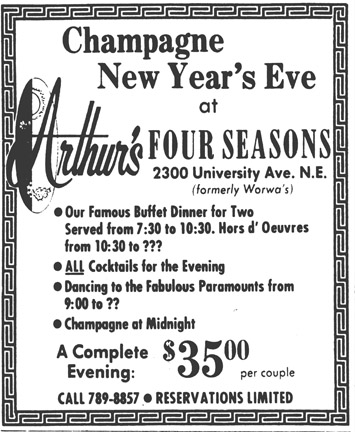
Minneapolis Star, December 13, 1968
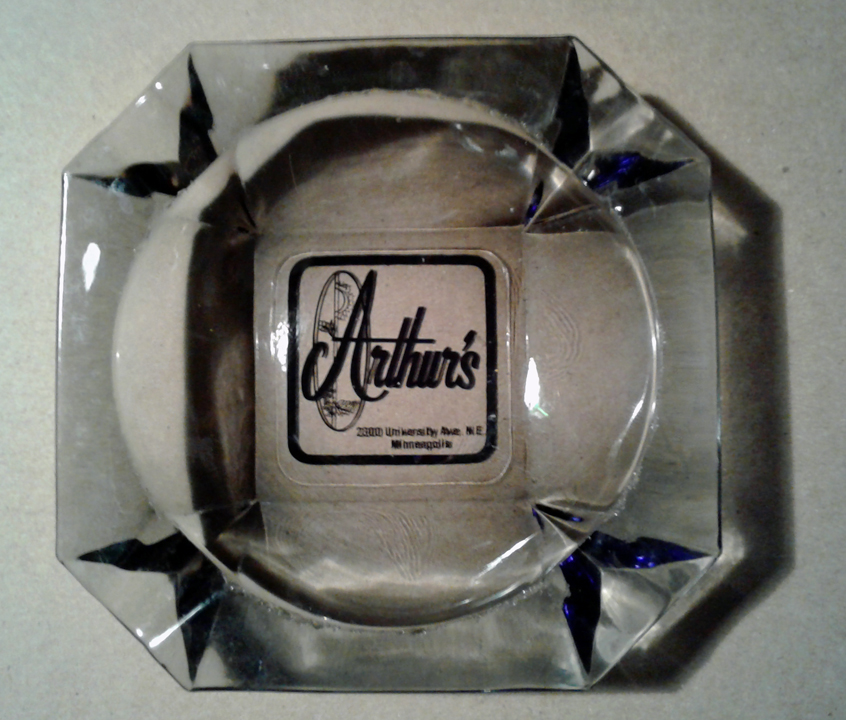
Courtesy Gary Tverberg
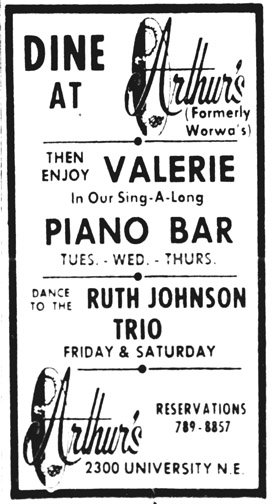
Minneapolis Tribune, March 28, 1969
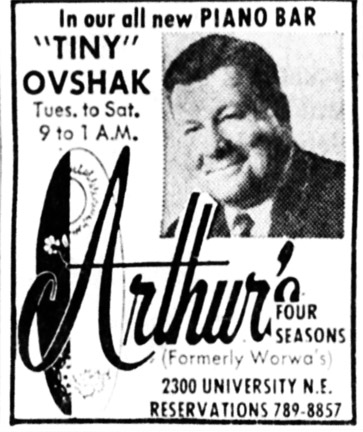
Minneapolis Star, July 10, 1969
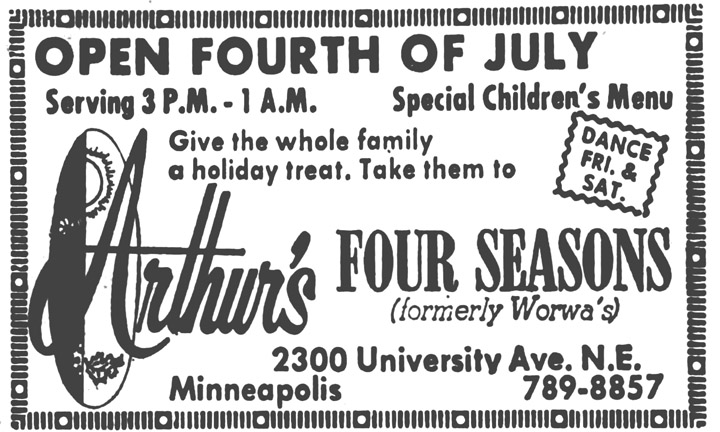
Minneapolis Star, July 2, 1970
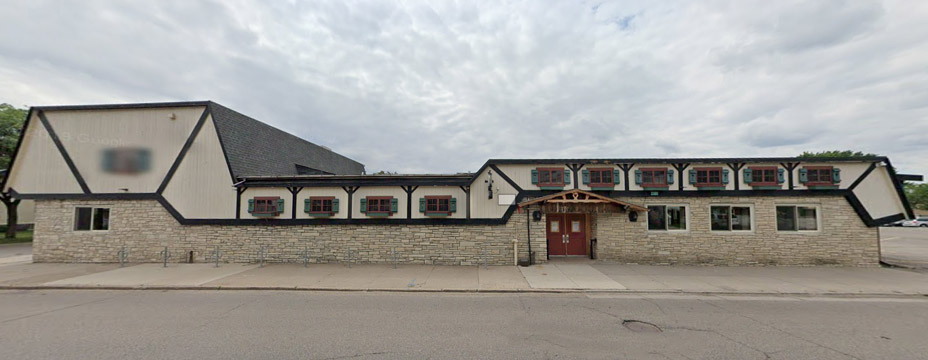
Is this the same building?
Please see Pershing Inn.
4th Street and 14th Ave. SE in Dinkytown above the Campus Cobbler – folk venue
White Bear Lake (teen club)
The YMCA (which city?) was apparently a hotbed of exciting entertainment for the boys in 1917. But watch your mouth: “Clean Speech, Clean Living.”
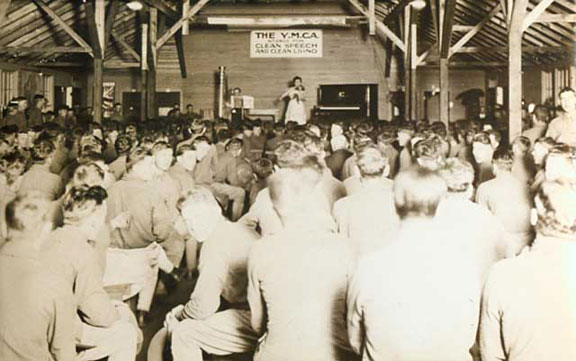
1917 photo courtesy Minnesota Historical Society
Please see Cascade 9.


